Autodesk 3ds Max 2008 Help Volume 1 En Vol
User Manual: autodesk 3ds Max - 2008 - Help Volume 1 Free User Guide for Autodesk 3ds Max Software, Manual
Open the PDF directly: View PDF ![]() .
.
Page Count: 3058 [warning: Documents this large are best viewed by clicking the View PDF Link!]

Help: Volume 1
Filename/description:
3dsMax08_Man_Help_fron.ai
Dimensions/specs:
177.8 mm x 228.6 mm
Part No.:
N/A
Date:
7.5.07
Colors: 4c process
CM Y K
Autodesk®
3ds Max®
2008
© 2007 Autodesk, Inc. All rights reserved. Except as otherwise permitted by Autodesk, Inc., this publication, or parts thereof, may not be
reproduced in any form, by any method, for any purpose.
Certain materials included in this publication are reprinted with the permission of the copyright holder.
Portions Copyrighted © 2005 Microsoft Corporation. All rights reserved.
Portions Copyrighted mental images GmbH 1989-2005.
This software contains source code provided by mental images GmbH.
Portions Copyright Max HTR created 2003-2005 by Motion Analysis.
Portions zlib © 2007 TinyXml.
REALVIZ Copyright © 2006 REALVIZ S.A. All rights reserved.
JPEG software is copyright © 1991-1998, Thomas G. Lane. All Rights Reserved. This software is based in part on the work of the Independent
JPEG Group.
Portions Copyrighted © 2005 Blur Studio, Inc.
Portions Copyrighted © 1989-2005 Joseph Alter, Inc. Credit to Joe Alter, Gonzalo Rueda, and Dean Edmonds.
Certain patents licensed from Viewpoint Corporation.
This product includes Radiance software (http://radsite.lbl.gov/radiance) developed by the Lawrence Berkeley National Laboratory
(http://www.lbl.gov). Copyright © 1990-2005. The Regents of the University of California through Lawrence Berkeley National Laboratory. All
rights reserved.
OpenEXR Bitmap I/O Plugin © 2003-2005 SplutterFish, LLC.
OpenEXR © 2003 Industrial Light and Magic a division of Lucas Digital Ltd. LLC.
Zlib © 1995-2003 Jean-loup Gaily and Mark Alder
Portions Copyrighted © 2000-2005 Size8 Software, Inc.
Portions Copyrighted © 2006 IntegrityWare, Inc.
Portions © Copyrighted 1999-2005 Havok.com Inc. (or its licensors). All Rights Reserved.
Portions Copyright 1998-2003 by Neil Hodgson. All Rights Reserved.
Portions of this software Point Cache 2 © 2005-2006 Blizzard Entertainment, Inc.
Portions Copyrighted © 2003 ATI Technologies, Inc. All Rights Reserved. Permission to use, copy, modify, and distribute this software and it
documentation for any purpose and without fee is hereby granted, provided that the above copyright notice appear in all copies and that both
that copyright notice and this permission notice appear in supporting documentation.
Portions Copyrighted © 1991, 1999 Free Software Foundation, Inc. Refer to GNU Lesser General Public License at
http://www.gnu.org/licenses/lgpl.html.
Copyright © 1991-1994 by Arthur D. Applegate. All Rights Reserved. No part of this source code may be copied, modified or reproduced in
any form without retaining the above copyright notice. This source code, or source code derived from it, may not be redistributed without
express written permission of the author.
Portions Copyrighted © 1999, 2000 NVIDIA Corporation. This file is provided without support, instructions or implied warranty of any kind.
NVIDIA makes no guarantee of its fitness for a particular purpose and is not liable under any circumstances for any damages or loss whatsoever
arising from the use or inability to use this file or items derived from it.
Portions Copyrighted © 2006 NVIDIA Corporation.
The following are registered trademarks or trademarks of Autodesk, Inc., in the USA and other countries: 3DEC (design/logo), 3December,
3December.com, 3ds Max, ActiveShapes, Actrix, ADI, Alias, Alias (swirl design/logo), AliasStudio, Alias|Wavefront (design/logo), ATC, AUGI,
AutoCAD, AutoCAD Learning Assistance, AutoCAD LT, AutoCAD Simulator, AutoCAD SQL Extension, AutoCAD SQL Interface, Autodesk, Autodesk
Envision, Autodesk Insight, Autodesk Intent, Autodesk Inventor, Autodesk Map, Autodesk MapGuide, Autodesk Streamline, AutoLISP, AutoSnap,
AutoSketch, AutoTrack, Backdraft, Built with ObjectARX (logo), Burn, Buzzsaw, CAiCE, Can You Imagine, Character Studio, Cinestream, Civil
3D, Cleaner, Cleaner Central, ClearScale, Colour Warper, Combustion, Communication Specification, Constructware, Content Explorer,
Create>what's>Next> (design/logo), Dancing Baby (image), DesignCenter, Design Doctor, Designer's Toolkit, DesignKids, DesignProf, DesignServer,
DesignStudio, Design|Studio (design/logo), Design Your World, Design Your World (design/logo), DWF, DWG, DWG (logo), DWG TrueConvert,
DWG TrueView, DXF, EditDV, Education by Design, Extending the Design Team, FBX, Filmbox, FMDesktop, Freewheel, GDX Driver, Gmax,
Heads-up Design, Heidi, HOOPS, HumanIK, i-drop, iMOUT, Incinerator, IntroDV, Inventor, Inventor LT, Kaydara, Kaydara (design/logo),
LocationLogic, Lustre, Maya, Mechanical Desktop, MotionBuilder, ObjectARX, ObjectDBX, Open Reality, PolarSnap, PortfolioWall, Powered with
Autodesk Technology, Productstream, ProjectPoint, Reactor, RealDWG, Real-time Roto, Render Queue, Revit, Showcase, SketchBook, StudioTools,
Topobase, Toxik, Visual, Visual Bridge, Visual Construction, Visual Drainage, Visual Hydro, Visual Landscape, Visual Roads, Visual Survey, Visual
Syllabus, Visual Toolbox, Visual Tugboat, Visual LISP, Voice Reality, Volo, and Wiretap.
The following are registered trademarks or trademarks of Autodesk Canada Co. in the USA and/or Canada and other countries: Backburner,
Discreet, Fire, Flame, Flint, Frost, Inferno, Multi-Master Editing, River, Smoke, Sparks, Stone, Wire.
mental images is a registered trademarks of mental images GmbH in the U.S.A. and/or other countries. clothfx™ is a trademark of Size8 Software,
Inc. Havok.com™ is a trademark or registered trademark of Havok.com Inc. or its licensors. Intel is a registered trademark of Intel Corporation.
All other brand names, product names or trademarks belong to their respective holders.
Disclaimer
THIS PUBLICATION AND THE INFORMATION CONTAINED HEREIN IS MADE AVAILABLE BY AUTODESK, INC. "AS IS." AUTODESK, INC., DISCLAIMS
ALL WARRANTIES, EITHER EXPRESS OR IMPLIED, INCLUDING BUT NOT LIMITED TO ANY IMPLIED WARRANTIES OF MERCHANTABILITY OR
FITNESS FOR A PARTICULAR PURPOSE REGARDING THESE MATERIALS.
Published by:
Autodesk, Inc.
111 Mclnnis Parkway
San Rafael, CA 94903, USA
Contents
Chapter 1 Introduction . . . . . . . . . . . . . . . . . . . . . . . . . . . . 1
What's New in Autodesk 3ds Max 2008 . . . . . . . . . . . . . . . . . . 1
What Was New in 3ds Max 9 Extension 1 . . . . . . . . . . . . . . . . . 8
3ds Max Documentation Set . . . . . . . . . . . . . . . . . . . . . . . 11
About MAXScript . . . . . . . . . . . . . . . . . . . . . . . . . . . . . 14
Chapter 2 Getting Started with 3ds Max . . . . . . . . . . . . . . . . . . 17
Project Workflow . . . . . . . . . . . . . . . . . . . . . . . . . . . . . 19
Setting Up Your Scene . . . . . . . . . . . . . . . . . . . . . . . . . . . 25
Modeling Objects . . . . . . . . . . . . . . . . . . . . . . . . . . . . . 26
Using Materials . . . . . . . . . . . . . . . . . . . . . . . . . . . . . . 27
Placing Lights and Cameras . . . . . . . . . . . . . . . . . . . . . . . . 30
Animating Your Scene . . . . . . . . . . . . . . . . . . . . . . . . . . . 33
Rendering Your Scene . . . . . . . . . . . . . . . . . . . . . . . . . . . 34
The 3ds Max Window . . . . . . . . . . . . . . . . . . . . . . . . . . . 35
Special Controls . . . . . . . . . . . . . . . . . . . . . . . . . . . . . . 38
Managing Files . . . . . . . . . . . . . . . . . . . . . . . . . . . . . . 44
Importing, Merging, Replacing, and Externally Referencing
Scenes . . . . . . . . . . . . . . . . . . . . . . . . . . . . . . . . . . 46
Using the Asset Browser . . . . . . . . . . . . . . . . . . . . . . . . . . 49
Startup Files and Defaults . . . . . . . . . . . . . . . . . . . . . . . . . 50
3dsmax .ini File . . . . . . . . . . . . . . . . . . . . . . . . . . . . . . 51
Backing Up and Archiving Scenes . . . . . . . . . . . . . . . . . . . . . 53
iii
Crash Recovery System . . . . . . . . . . . . . . . . . . . . . . . . . . 53
Chapter 3 Viewing and Navigating 3D Space . . . . . . . . . . . . . . . . 55
General Viewport Concepts . . . . . . . . . . . . . . . . . . . . . . . . 56
Home Grid: Views Based on the World Coordinate Axes . . . . . . . . . 58
Understanding Views . . . . . . . . . . . . . . . . . . . . . . . . . . . 61
Setting Viewport Layout . . . . . . . . . . . . . . . . . . . . . . . . . . 65
Controlling Viewport Rendering . . . . . . . . . . . . . . . . . . . . . 68
Controlling Display Performance . . . . . . . . . . . . . . . . . . . . . 70
Using Standard View Navigation . . . . . . . . . . . . . . . . . . . . . 71
Zooming, Panning, and Rotating Views . . . . . . . . . . . . . . . . . 72
Using Walkthrough Navigation . . . . . . . . . . . . . . . . . . . . . . 75
Navigating Camera and Light Views . . . . . . . . . . . . . . . . . . . 79
Adaptive Degradation . . . . . . . . . . . . . . . . . . . . . . . . . . 83
Grab Viewport . . . . . . . . . . . . . . . . . . . . . . . . . . . . . . . 85
View-Handling Commands . . . . . . . . . . . . . . . . . . . . . . . . 86
Undo View Change / Redo View Change . . . . . . . . . . . . . . 87
Save Active View . . . . . . . . . . . . . . . . . . . . . . . . . . 88
Restore Active View . . . . . . . . . . . . . . . . . . . . . . . . . 88
Viewport Background Dialog . . . . . . . . . . . . . . . . . . . . 89
Select Background Image Dialog . . . . . . . . . . . . . . . . . . 97
Update Background Image . . . . . . . . . . . . . . . . . . . . . 102
Reset Background Transform . . . . . . . . . . . . . . . . . . . 103
Show Transform Gizmo . . . . . . . . . . . . . . . . . . . . . . 103
Show Ghosting . . . . . . . . . . . . . . . . . . . . . . . . . . . 104
Show Key Times . . . . . . . . . . . . . . . . . . . . . . . . . . 105
Shade Selected . . . . . . . . . . . . . . . . . . . . . . . . . . . 107
Show Dependencies . . . . . . . . . . . . . . . . . . . . . . . . 108
Create Camera From View . . . . . . . . . . . . . . . . . . . . . 109
Add Default Lights to Scene . . . . . . . . . . . . . . . . . . . . 111
Redraw All Views . . . . . . . . . . . . . . . . . . . . . . . . . . 113
Global Viewport Rendering Setting . . . . . . . . . . . . . . . . 114
Update During Spinner Drag . . . . . . . . . . . . . . . . . . . 115
Diagnose Video Hardware . . . . . . . . . . . . . . . . . . . . . 115
Expert Mode . . . . . . . . . . . . . . . . . . . . . . . . . . . . 116
Controlling Object Display . . . . . . . . . . . . . . . . . . . . . . . 117
Display Color Rollout . . . . . . . . . . . . . . . . . . . . . . . 117
Hide By Category Rollout . . . . . . . . . . . . . . . . . . . . . 118
Hide Rollout . . . . . . . . . . . . . . . . . . . . . . . . . . . . 120
Freeze Rollout . . . . . . . . . . . . . . . . . . . . . . . . . . . 122
Display Properties Rollout . . . . . . . . . . . . . . . . . . . . . 124
Link Display Rollout . . . . . . . . . . . . . . . . . . . . . . . . 129
Chapter 4 Selecting Objects . . . . . . . . . . . . . . . . . . . . . . . . . 131
Introducing Object Selection . . . . . . . . . . . . . . . . . . . . . . 132
iv | Contents
Basics of Selecting Objects . . . . . . . . . . . . . . . . . . . . . . . . 139
Selecting by Region . . . . . . . . . . . . . . . . . . . . . . . . . . . 143
Using Select By Name . . . . . . . . . . . . . . . . . . . . . . . . . . 146
Using Named Selection Sets . . . . . . . . . . . . . . . . . . . . . . . 146
Using Selection Filters . . . . . . . . . . . . . . . . . . . . . . . . . . 148
Selecting with Track View . . . . . . . . . . . . . . . . . . . . . . . . 150
Selecting with Schematic View . . . . . . . . . . . . . . . . . . . . . 151
Freezing and Unfreezing Objects . . . . . . . . . . . . . . . . . . . . 152
Hiding and Unhiding Objects by Selection . . . . . . . . . . . . . . . 154
Hiding and Unhiding Objects by Category . . . . . . . . . . . . . . . 156
Isolate Selection . . . . . . . . . . . . . . . . . . . . . . . . . . . . . 159
Introduction to Sub-Object Selection . . . . . . . . . . . . . . . . . . 160
Selection Commands . . . . . . . . . . . . . . . . . . . . . . . . . . 165
Select Object . . . . . . . . . . . . . . . . . . . . . . . . . . . . 167
Select From Scene . . . . . . . . . . . . . . . . . . . . . . . . . 168
Selection Floater . . . . . . . . . . . . . . . . . . . . . . . . . . 171
Selection Region Flyout . . . . . . . . . . . . . . . . . . . . . . 174
Selection Filter List . . . . . . . . . . . . . . . . . . . . . . . . . 176
Filter Combinations Dialog . . . . . . . . . . . . . . . . . . . . 177
Named Selection Sets . . . . . . . . . . . . . . . . . . . . . . . 179
Named Selection Sets Dialog . . . . . . . . . . . . . . . . 181
Edit Named Selections Dialog . . . . . . . . . . . . . . . . 186
Select All . . . . . . . . . . . . . . . . . . . . . . . . . . . . . . 189
Select None . . . . . . . . . . . . . . . . . . . . . . . . . . . . . 189
Select Invert . . . . . . . . . . . . . . . . . . . . . . . . . . . . 190
Select Similar . . . . . . . . . . . . . . . . . . . . . . . . . . . . 190
Select By . . . . . . . . . . . . . . . . . . . . . . . . . . . . . . 191
Select By Color . . . . . . . . . . . . . . . . . . . . . . . . 191
Select By Name (Edit Menu) . . . . . . . . . . . . . . . . . 191
Select By Layer . . . . . . . . . . . . . . . . . . . . . . . . 192
Region Selection . . . . . . . . . . . . . . . . . . . . . . . . . . 192
Selection Region . . . . . . . . . . . . . . . . . . . . . . . 192
Rectangular Selection Region . . . . . . . . . . . . . . . . 192
Circular Selection Region . . . . . . . . . . . . . . . . . . 193
Fence Selection Region . . . . . . . . . . . . . . . . . . . 194
Lasso Selection Region . . . . . . . . . . . . . . . . . . . 195
Paint Selection Region . . . . . . . . . . . . . . . . . . . 196
Region . . . . . . . . . . . . . . . . . . . . . . . . . . . . 197
Select Region Window . . . . . . . . . . . . . . . . . . . 198
Select Region Crossing . . . . . . . . . . . . . . . . . . . 200
Window/Crossing Selection Toggle . . . . . . . . . . . . . 201
Edit Commands . . . . . . . . . . . . . . . . . . . . . . . . . . . . . 202
Undo/Redo . . . . . . . . . . . . . . . . . . . . . . . . . . . . 202
Hold/Fetch . . . . . . . . . . . . . . . . . . . . . . . . . . . . . 204
Delete . . . . . . . . . . . . . . . . . . . . . . . . . . . . . . . 205
Groups and Assemblies . . . . . . . . . . . . . . . . . . . . . . . . . 205
Contents | v
Using Groups . . . . . . . . . . . . . . . . . . . . . . . . . . . 206
Using Assemblies . . . . . . . . . . . . . . . . . . . . . . . . . . 209
Character Assembly . . . . . . . . . . . . . . . . . . . . . . . . 217
Group Commands . . . . . . . . . . . . . . . . . . . . . . . . . 221
Group . . . . . . . . . . . . . . . . . . . . . . . . . . . . 222
Open Group . . . . . . . . . . . . . . . . . . . . . . . . . 223
Close Group . . . . . . . . . . . . . . . . . . . . . . . . . 223
Ungroup . . . . . . . . . . . . . . . . . . . . . . . . . . . 224
Explode Group . . . . . . . . . . . . . . . . . . . . . . . . 225
Detach Group . . . . . . . . . . . . . . . . . . . . . . . . 225
Attach Group . . . . . . . . . . . . . . . . . . . . . . . . 226
Assembly Commands . . . . . . . . . . . . . . . . . . . . . . . 226
Assemble . . . . . . . . . . . . . . . . . . . . . . . . . . . 227
Open Assembly . . . . . . . . . . . . . . . . . . . . . . . 231
Close Assembly . . . . . . . . . . . . . . . . . . . . . . . 232
Disassemble . . . . . . . . . . . . . . . . . . . . . . . . . 233
Explode Assembly . . . . . . . . . . . . . . . . . . . . . . 233
Detach Assembly . . . . . . . . . . . . . . . . . . . . . . . 234
Attach Assembly . . . . . . . . . . . . . . . . . . . . . . . 234
Assembly Head Helper Objects . . . . . . . . . . . . . . . . . . 234
Assembly Head Helper Object . . . . . . . . . . . . . . . . 234
Luminaire Helper Object . . . . . . . . . . . . . . . . . . 235
Character Assembly Commands . . . . . . . . . . . . . . . . . 237
Create Character . . . . . . . . . . . . . . . . . . . . . . . 238
Destroy Character . . . . . . . . . . . . . . . . . . . . . . 242
Lock/Unlock Character . . . . . . . . . . . . . . . . . . . 242
Insert Character . . . . . . . . . . . . . . . . . . . . . . . 243
Save Character . . . . . . . . . . . . . . . . . . . . . . . . 243
Skin Pose Commands . . . . . . . . . . . . . . . . . . . . 244
Chapter 5 Object Properties . . . . . . . . . . . . . . . . . . . . . . . . 245
Object Properties Dialog Panels . . . . . . . . . . . . . . . . . . . . . 245
General Panel (Object Properties Dialog) . . . . . . . . . . . . . 245
Advanced Lighting Panel (Object Properties Dialog) . . . . . . . 256
mental ray Panel (Object Properties Dialog) . . . . . . . . . . . 262
User Defined Panel (Object Properties Dialog) . . . . . . . . . . 264
Rename Objects Tool . . . . . . . . . . . . . . . . . . . . . . . . . . . 266
Custom Attributes . . . . . . . . . . . . . . . . . . . . . . . . . . . . 267
Parameter Collector . . . . . . . . . . . . . . . . . . . . . . . . . . . 285
Parameter Collector Menu Bar . . . . . . . . . . . . . . . . . . . 294
Notes Dialog (Parameter Collector) . . . . . . . . . . . . . . . . 297
Expression Techniques . . . . . . . . . . . . . . . . . . . . . . . . . . 299
Trigonometric Functions . . . . . . . . . . . . . . . . . . . . . . 309
Vectors . . . . . . . . . . . . . . . . . . . . . . . . . . . . . . . 312
vi | Contents
Chapter 6 Creating Geometry . . . . . . . . . . . . . . . . . . . . . . . 317
Basics of Creating and Modifying Objects . . . . . . . . . . . . . . . . 317
Using the Create Panel . . . . . . . . . . . . . . . . . . . . . . . 319
Identifying the Basic Building Blocks . . . . . . . . . . . . . . . 321
Creating an Object . . . . . . . . . . . . . . . . . . . . . . . . . 323
Assigning Colors to Objects . . . . . . . . . . . . . . . . . . . . 327
Object Color Dialog . . . . . . . . . . . . . . . . . . . . . 327
Color Selector Dialog . . . . . . . . . . . . . . . . . . . . 331
Color Clipboard Utility . . . . . . . . . . . . . . . . . . . 337
Adjusting Normals and Smoothing . . . . . . . . . . . . . . . . 339
Viewing and Changing Normals . . . . . . . . . . . . . . 340
Viewing and Changing Smoothing . . . . . . . . . . . . . 343
Geometric Primitives . . . . . . . . . . . . . . . . . . . . . . . . . . . 345
Creating Primitives from the Keyboard . . . . . . . . . . . . . . 346
Standard Primitives . . . . . . . . . . . . . . . . . . . . . . . . 348
Box Primitive . . . . . . . . . . . . . . . . . . . . . . . . 350
Cone Primitive . . . . . . . . . . . . . . . . . . . . . . . . 353
Sphere Primitive . . . . . . . . . . . . . . . . . . . . . . . 356
GeoSphere Primitive . . . . . . . . . . . . . . . . . . . . . 361
Cylinder Primitive . . . . . . . . . . . . . . . . . . . . . . 364
Tube Primitive . . . . . . . . . . . . . . . . . . . . . . . . 367
Torus Primitive . . . . . . . . . . . . . . . . . . . . . . . . 370
Pyramid Primitive . . . . . . . . . . . . . . . . . . . . . . 374
Teapot Primitive . . . . . . . . . . . . . . . . . . . . . . . 377
Plane Primitive . . . . . . . . . . . . . . . . . . . . . . . . 380
Extended Primitives . . . . . . . . . . . . . . . . . . . . . . . . 383
Hedra Extended Primitive . . . . . . . . . . . . . . . . . . 385
Torus Knot Extended Primitive . . . . . . . . . . . . . . . 389
ChamferBox Extended Primitive . . . . . . . . . . . . . . 393
ChamferCyl Extended Primitive . . . . . . . . . . . . . . . 396
OilTank Extended Primitive . . . . . . . . . . . . . . . . . 399
Capsule Extended Primitive . . . . . . . . . . . . . . . . . 402
Spindle Extended Primitive . . . . . . . . . . . . . . . . . 405
L-Ext Extended Primitive . . . . . . . . . . . . . . . . . . 409
Gengon Extended Primitive . . . . . . . . . . . . . . . . . 411
C-Ext Extended Primitive . . . . . . . . . . . . . . . . . . 414
RingWave Extended Primitive . . . . . . . . . . . . . . . . 417
Prism Extended Primitive . . . . . . . . . . . . . . . . . . 423
Hose Extended Primitive . . . . . . . . . . . . . . . . . . 425
Architectural Objects . . . . . . . . . . . . . . . . . . . . . . . . . . . 432
AEC Extended Objects . . . . . . . . . . . . . . . . . . . . . . . 433
Working with AEC Design Elements . . . . . . . . . . . . 433
Foliage . . . . . . . . . . . . . . . . . . . . . . . . . . . . 439
Railing . . . . . . . . . . . . . . . . . . . . . . . . . . . . 447
Wall . . . . . . . . . . . . . . . . . . . . . . . . . . . . . 456
Editing Wall Objects . . . . . . . . . . . . . . . . . . . . . 466
Contents | vii
Stairs . . . . . . . . . . . . . . . . . . . . . . . . . . . . . . . . 471
L-Type Stair . . . . . . . . . . . . . . . . . . . . . . . . . 473
Spiral Stair . . . . . . . . . . . . . . . . . . . . . . . . . . 480
Straight Stair . . . . . . . . . . . . . . . . . . . . . . . . . 488
U-Type Stair . . . . . . . . . . . . . . . . . . . . . . . . . 495
Doors . . . . . . . . . . . . . . . . . . . . . . . . . . . . . . . . 502
Pivot Door . . . . . . . . . . . . . . . . . . . . . . . . . . 510
Sliding Door . . . . . . . . . . . . . . . . . . . . . . . . . 512
BiFold Door . . . . . . . . . . . . . . . . . . . . . . . . . 514
Windows . . . . . . . . . . . . . . . . . . . . . . . . . . . . . . 516
Awning Window . . . . . . . . . . . . . . . . . . . . . . . 523
Casement Window . . . . . . . . . . . . . . . . . . . . . . 526
Fixed Window . . . . . . . . . . . . . . . . . . . . . . . . 528
Pivoted Window . . . . . . . . . . . . . . . . . . . . . . . 530
Projected Window . . . . . . . . . . . . . . . . . . . . . . 532
Sliding Window . . . . . . . . . . . . . . . . . . . . . . . 534
Shapes . . . . . . . . . . . . . . . . . . . . . . . . . . . . . . . . . . 536
Shape Check Utility . . . . . . . . . . . . . . . . . . . . . . . . 541
Splines and Extended Splines . . . . . . . . . . . . . . . . . . . 542
Line Spline . . . . . . . . . . . . . . . . . . . . . . . . . . 551
Rectangle Spline . . . . . . . . . . . . . . . . . . . . . . . 555
Circle Spline . . . . . . . . . . . . . . . . . . . . . . . . . 557
Ellipse Spline . . . . . . . . . . . . . . . . . . . . . . . . . 559
Arc Spline . . . . . . . . . . . . . . . . . . . . . . . . . . 560
Donut Spline . . . . . . . . . . . . . . . . . . . . . . . . . 564
NGon Spline . . . . . . . . . . . . . . . . . . . . . . . . . 565
Star Spline . . . . . . . . . . . . . . . . . . . . . . . . . . 567
Text Spline . . . . . . . . . . . . . . . . . . . . . . . . . . 569
Helix Spline . . . . . . . . . . . . . . . . . . . . . . . . . 574
Section Spline . . . . . . . . . . . . . . . . . . . . . . . . 576
Extended Splines . . . . . . . . . . . . . . . . . . . . . . . . . . 580
WRectangle Spline . . . . . . . . . . . . . . . . . . . . . . 580
Channel Spline . . . . . . . . . . . . . . . . . . . . . . . 583
Angle Spline . . . . . . . . . . . . . . . . . . . . . . . . . 585
Tee Spline . . . . . . . . . . . . . . . . . . . . . . . . . . 587
Wide Flange Spline . . . . . . . . . . . . . . . . . . . . . 588
Editable Spline . . . . . . . . . . . . . . . . . . . . . . . . . . . 590
Editable Spline (Object) . . . . . . . . . . . . . . . . . . . 602
Editable Spline (Vertex) . . . . . . . . . . . . . . . . . . . 606
Editable Spline (Segment) . . . . . . . . . . . . . . . . . . 618
Editable Spline (Spline) . . . . . . . . . . . . . . . . . . . 627
Compound Objects . . . . . . . . . . . . . . . . . . . . . . . . . . . 638
Morph Compound Object . . . . . . . . . . . . . . . . . . . . . 639
Scatter Compound Object . . . . . . . . . . . . . . . . . . . . . 647
Conform Compound Object . . . . . . . . . . . . . . . . . . . . 660
Connect Compound Object . . . . . . . . . . . . . . . . . . . . 668
viii | Contents
BlobMesh Compound Object . . . . . . . . . . . . . . . . . . . 674
ShapeMerge Compound Object . . . . . . . . . . . . . . . . . . 681
Boolean Compound Object . . . . . . . . . . . . . . . . . . . . 686
Material Attach Options Dialog . . . . . . . . . . . . . . . 701
Terrain Compound Object . . . . . . . . . . . . . . . . . . . . . 703
Loft Compound Object . . . . . . . . . . . . . . . . . . . . . . 715
Creation Method Rollout . . . . . . . . . . . . . . . . . . 718
Surface Parameters Rollout . . . . . . . . . . . . . . . . . 719
Path Parameters Rollout . . . . . . . . . . . . . . . . . . . 724
Skin Parameters Rollout . . . . . . . . . . . . . . . . . . . 727
Deformations . . . . . . . . . . . . . . . . . . . . . . . . 744
Deform Scale . . . . . . . . . . . . . . . . . . . . . . . . . 745
Deform Twist . . . . . . . . . . . . . . . . . . . . . . . . . 747
Deform Teeter . . . . . . . . . . . . . . . . . . . . . . . . 749
Deform Bevel . . . . . . . . . . . . . . . . . . . . . . . . . 752
Deform Fit . . . . . . . . . . . . . . . . . . . . . . . . . . 754
Deformation Dialog . . . . . . . . . . . . . . . . . . . . . 756
Path Commands . . . . . . . . . . . . . . . . . . . . . . . 763
Shape Commands . . . . . . . . . . . . . . . . . . . . . . 764
Compare Dialog . . . . . . . . . . . . . . . . . . . . . . . 765
Mesher Compound Object . . . . . . . . . . . . . . . . . . . . . 767
ProBoolean/ProCutter Compound Objects . . . . . . . . . . . . 772
ProBoolean Compound Object . . . . . . . . . . . . . . . 774
ProCutter Compound Object . . . . . . . . . . . . . . . . 792
Quad Meshing and Smoothing . . . . . . . . . . . . . . . 799
Dynamics Objects . . . . . . . . . . . . . . . . . . . . . . . . . . . . 810
Damper Dynamics Object . . . . . . . . . . . . . . . . . . . . . 811
Spring Dynamics Object . . . . . . . . . . . . . . . . . . . . . . 820
Systems . . . . . . . . . . . . . . . . . . . . . . . . . . . . . . . . . . 829
Bones System . . . . . . . . . . . . . . . . . . . . . . . . . . . . 831
Using Objects as Bones . . . . . . . . . . . . . . . . . . . 843
Bone Tools . . . . . . . . . . . . . . . . . . . . . . . . . . 845
Bone Tools Rollouts . . . . . . . . . . . . . . . . . . . . . 845
Ring Array System . . . . . . . . . . . . . . . . . . . . . . . . . 853
Chapter 7 Moving, Rotating, and Scaling Objects . . . . . . . . . . . . . 859
Axis Tripod and World Axis . . . . . . . . . . . . . . . . . . . . . . . 860
Using Transforms . . . . . . . . . . . . . . . . . . . . . . . . . . . . 862
Using Transform Gizmos . . . . . . . . . . . . . . . . . . . . . 865
Transform Type-In . . . . . . . . . . . . . . . . . . . . . . . . . 874
Animating Transforms . . . . . . . . . . . . . . . . . . . . . . . 877
Transform Managers . . . . . . . . . . . . . . . . . . . . . . . . 879
Specifying a Reference Coordinate System . . . . . . . . . . . . 881
Choosing a Transform Center . . . . . . . . . . . . . . . . . . . 882
Using the Axis Constraints . . . . . . . . . . . . . . . . . . . . 884
Reset Transform Utility . . . . . . . . . . . . . . . . . . . . . . 886
Contents | ix
Transform Commands . . . . . . . . . . . . . . . . . . . . . . . . . . 887
Select and Move . . . . . . . . . . . . . . . . . . . . . . . . . . 888
Select and Rotate . . . . . . . . . . . . . . . . . . . . . . . . . 889
Select and Scale . . . . . . . . . . . . . . . . . . . . . . . . . . 891
Select and Uniform Scale . . . . . . . . . . . . . . . . . . . . . 892
Select and Non-Uniform Scale . . . . . . . . . . . . . . . . . . 893
Select and Squash . . . . . . . . . . . . . . . . . . . . . . . . . 894
Transform Coordinates and Coordinate Center . . . . . . . . . . . . . 896
Reference Coordinate System . . . . . . . . . . . . . . . . . . . 896
Use Center Flyout . . . . . . . . . . . . . . . . . . . . . . . . . 904
Use Pivot Point Center . . . . . . . . . . . . . . . . . . . . . . 905
Use Selection Center . . . . . . . . . . . . . . . . . . . . . . . 907
Use Transform Coordinate Center . . . . . . . . . . . . . . . . 908
Transform Tools . . . . . . . . . . . . . . . . . . . . . . . . . . . . . 909
Array Flyout . . . . . . . . . . . . . . . . . . . . . . . . . . . . 911
Mirror Selected Objects . . . . . . . . . . . . . . . . . . . . . . 911
Array . . . . . . . . . . . . . . . . . . . . . . . . . . . . . . . . 915
Snapshot . . . . . . . . . . . . . . . . . . . . . . . . . . . . . . 921
Spacing Tool . . . . . . . . . . . . . . . . . . . . . . . . . . . . 925
Clone and Align Tool . . . . . . . . . . . . . . . . . . . . . . . 933
Align Flyout . . . . . . . . . . . . . . . . . . . . . . . . . . . . 938
Align . . . . . . . . . . . . . . . . . . . . . . . . . . . . . . . . 938
Quick Align . . . . . . . . . . . . . . . . . . . . . . . . . . . . 944
Normal Align . . . . . . . . . . . . . . . . . . . . . . . . . . . 945
Place Highlight . . . . . . . . . . . . . . . . . . . . . . . . . . 948
Align Camera . . . . . . . . . . . . . . . . . . . . . . . . . . . 950
Align to View . . . . . . . . . . . . . . . . . . . . . . . . . . . 951
Chapter 8 Creating Copies and Arrays . . . . . . . . . . . . . . . . . . . 953
Overview of Copies, Instances, and References . . . . . . . . . . . . . 955
Techniques for Cloning Objects . . . . . . . . . . . . . . . . . . . . . 958
Clone . . . . . . . . . . . . . . . . . . . . . . . . . . . . . . . . 965
Clone Options Dialog . . . . . . . . . . . . . . . . . . . . . . . 965
Using Shift+Clone . . . . . . . . . . . . . . . . . . . . . . . . . 968
Cloning with Shift+Move . . . . . . . . . . . . . . . . . . . . . 970
Cloning with Shift+Rotate . . . . . . . . . . . . . . . . . . . . . 972
Cloning with Shift+Scale . . . . . . . . . . . . . . . . . . . . . 975
Animating Shift+Rotate and Shift+Scale . . . . . . . . . . . . . . 977
Cloning Objects Over Time with Snapshot . . . . . . . . . . . . 979
Arraying Objects . . . . . . . . . . . . . . . . . . . . . . . . . . . . . 981
Using the Array Dialog . . . . . . . . . . . . . . . . . . . . . . . 983
Creating Linear Arrays . . . . . . . . . . . . . . . . . . . . . . . 989
Creating Circular and Spiral Arrays . . . . . . . . . . . . . . . . 993
Mirroring Objects . . . . . . . . . . . . . . . . . . . . . . . . . . . . 996
Using the Spacing Tool . . . . . . . . . . . . . . . . . . . . . . . . . . 998
x | Contents
Chapter 9 Modifiers . . . . . . . . . . . . . . . . . . . . . . . . . . . . 1001
Transforms, Modifiers, and Object Data Flow . . . . . . . . . . . . . 1004
List of Available Modifiers . . . . . . . . . . . . . . . . . . . . . . . 1011
Using Modifiers . . . . . . . . . . . . . . . . . . . . . . . . . . . . . 1015
Using the Modify Panel . . . . . . . . . . . . . . . . . . . . . 1016
Using the Modifier Stack . . . . . . . . . . . . . . . . . . . . . 1020
Editing the Stack . . . . . . . . . . . . . . . . . . . . . . . . . 1023
Edit Modifiers and Editable Objects . . . . . . . . . . . . . . . 1027
Modifying at the Sub-Object Level . . . . . . . . . . . . . . . . 1029
Using the Stack at the Sub-Object Level . . . . . . . . . . . . . 1032
Modifying Multiple Objects . . . . . . . . . . . . . . . . . . . 1034
How Instanced Modifiers Work . . . . . . . . . . . . . . . . . 1040
World-Space Modifiers (WSMs) . . . . . . . . . . . . . . . . . . . . . 1043
Camera Map Modifier (World Space) . . . . . . . . . . . . . . 1043
Displace Mesh Modifier (World Space) . . . . . . . . . . . . . . 1045
Displace NURBS Modifier (World Space) . . . . . . . . . . . . . 1047
Hair And Fur Modifier . . . . . . . . . . . . . . . . . . . . . . 1049
Selection Rollout (Hair and Fur) . . . . . . . . . . . . . . 1059
Tools Rollout (Hair and Fur) . . . . . . . . . . . . . . . . 1061
Styling Rollout (Hair and Fur) . . . . . . . . . . . . . . . 1070
Quad Menu for Hair Styling . . . . . . . . . . . . . . . . 1082
General Parameters Rollout (Hair and Fur) . . . . . . . . 1084
Material Parameters Rollout (Hair and Fur) . . . . . . . . 1091
mr Parameters Rollout (Hair and Fur) . . . . . . . . . . . 1098
Frizz Parameters Rollout (Hair and Fur) . . . . . . . . . . 1099
Kink Parameters Rollout (Hair and Fur) . . . . . . . . . . 1104
Multi Strand Parameters Rollout (Hair and Fur) . . . . . . 1107
Dynamics Rollout (Hair and Fur) . . . . . . . . . . . . . . 1109
Display Rollout (Hair and Fur) . . . . . . . . . . . . . . . 1116
LS Colors Modifier (World Space) . . . . . . . . . . . . . . . . 1118
MapScaler Modifier (World Space) . . . . . . . . . . . . . . . . 1120
PatchDeform Modifier (World Space) . . . . . . . . . . . . . . 1123
PathDeform Modifier (World Space) . . . . . . . . . . . . . . . 1123
Point Cache Modifier (World Space) . . . . . . . . . . . . . . . 1129
Subdivide Modifier (World Space) . . . . . . . . . . . . . . . . 1129
Surface Mapper Modifier (World Space) . . . . . . . . . . . . . 1129
SurfDeform Modifier (World Space) . . . . . . . . . . . . . . . 1132
Object-Space Modifiers . . . . . . . . . . . . . . . . . . . . . . . . . 1132
Affect Region Modifier . . . . . . . . . . . . . . . . . . . . . . 1133
Attribute Holder Modifier . . . . . . . . . . . . . . . . . . . . 1136
Bend Modifier . . . . . . . . . . . . . . . . . . . . . . . . . . 1139
Bevel Modifier . . . . . . . . . . . . . . . . . . . . . . . . . . 1142
Bevel Profile Modifier . . . . . . . . . . . . . . . . . . . . . . . 1150
Camera Map Modifier (Object Space) . . . . . . . . . . . . . . 1154
Cap Holes Modifier . . . . . . . . . . . . . . . . . . . . . . . . 1159
Cloth and Garment Maker Modifiers . . . . . . . . . . . . . . 1162
Contents | xi
Cloth Overview . . . . . . . . . . . . . . . . . . . . . . . 1163
Cloth Modifier . . . . . . . . . . . . . . . . . . . . . . . 1178
Object Properties Dialog (Cloth) . . . . . . . . . . . . . . 1219
Garment Maker Modifier . . . . . . . . . . . . . . . . . . 1228
Troubleshooting and Error Codes in Garment Maker . . . 1258
CrossSection Modifier . . . . . . . . . . . . . . . . . . . . . . 1259
Delete Mesh Modifier . . . . . . . . . . . . . . . . . . . . . . . 1266
Delete Patch Modifier . . . . . . . . . . . . . . . . . . . . . . 1267
Delete Spline Modifier . . . . . . . . . . . . . . . . . . . . . . 1269
Disp Approx Modifier . . . . . . . . . . . . . . . . . . . . . . 1270
Displace Modifier . . . . . . . . . . . . . . . . . . . . . . . . . 1274
Edit Mesh Modifier . . . . . . . . . . . . . . . . . . . . . . . . 1283
Edit Normals Modifier . . . . . . . . . . . . . . . . . . . . . . 1284
Edit Patch Modifier . . . . . . . . . . . . . . . . . . . . . . . . 1290
Edit Poly Modifier . . . . . . . . . . . . . . . . . . . . . . . . 1293
Selection Rollout (Edit Poly Modifier) . . . . . . . . . . . 1307
Edit Poly (Object) . . . . . . . . . . . . . . . . . . . . . . 1319
Edit Poly (Vertex) . . . . . . . . . . . . . . . . . . . . . 1321
Edit Poly (Edge) . . . . . . . . . . . . . . . . . . . . . . 1330
Edit Poly (Border) . . . . . . . . . . . . . . . . . . . . . 1343
Edit Poly (Polygon/Element) . . . . . . . . . . . . . . . 1350
Edit Geometry Rollout (Edit Poly Modifier) . . . . . . . . 1363
Align Geometry Dialog . . . . . . . . . . . . . . . . . . . 1375
Detach Dialog . . . . . . . . . . . . . . . . . . . . . . . 1375
Edit Spline Modifier . . . . . . . . . . . . . . . . . . . . . . . 1376
Extrude Modifier . . . . . . . . . . . . . . . . . . . . . . . . . 1377
Face Extrude Modifier . . . . . . . . . . . . . . . . . . . . . . 1381
FFD (Free-Form Deformation) Modifiers . . . . . . . . . . . . . 1383
FFD (Box/Cylinder) Modifiers . . . . . . . . . . . . . . . . . . 1389
FFD (Free-Form Deformation) Select Modifier . . . . . . . . . . 1395
Fillet/Chamfer Modifier . . . . . . . . . . . . . . . . . . . . . 1396
Flex Modifier . . . . . . . . . . . . . . . . . . . . . . . . . . . 1400
Spring Option Dialog . . . . . . . . . . . . . . . . . . . . 1418
HSDS Modifier . . . . . . . . . . . . . . . . . . . . . . . . . . 1420
Adaptive Subdivision Dialog . . . . . . . . . . . . . . . . 1428
Lathe Modifier . . . . . . . . . . . . . . . . . . . . . . . . . . 1430
Lattice Modifier . . . . . . . . . . . . . . . . . . . . . . . . . . 1435
Linked XForm Modifier . . . . . . . . . . . . . . . . . . . . . 1440
LS Mesh Modifier . . . . . . . . . . . . . . . . . . . . . . . . . 1442
MapScaler Modifier (Object Space) . . . . . . . . . . . . . . . . 1443
Material Modifier . . . . . . . . . . . . . . . . . . . . . . . . . 1445
MaterialByElement Modifier . . . . . . . . . . . . . . . . . . . 1448
Melt Modifier . . . . . . . . . . . . . . . . . . . . . . . . . . . 1451
Mesh Select Modifier . . . . . . . . . . . . . . . . . . . . . . . 1455
MeshSmooth Modifier . . . . . . . . . . . . . . . . . . . . . . 1460
Mirror Modifier . . . . . . . . . . . . . . . . . . . . . . . . . . 1471
xii | Contents
Morpher Modifier . . . . . . . . . . . . . . . . . . . . . . . . . 1473
MultiRes Modifier . . . . . . . . . . . . . . . . . . . . . . . . 1493
Noise Modifier . . . . . . . . . . . . . . . . . . . . . . . . . . 1501
Normal Modifier . . . . . . . . . . . . . . . . . . . . . . . . . 1509
Normalize Spline Modifier . . . . . . . . . . . . . . . . . . . . 1511
NSurf Sel Modifier . . . . . . . . . . . . . . . . . . . . . . . . 1513
Optimize Modifier . . . . . . . . . . . . . . . . . . . . . . . . 1515
Patch Select Modifier . . . . . . . . . . . . . . . . . . . . . . . 1520
PatchDeform Modifier . . . . . . . . . . . . . . . . . . . . . . 1525
PathDeform Modifier . . . . . . . . . . . . . . . . . . . . . . . 1528
Point Cache Modifier . . . . . . . . . . . . . . . . . . . . . . . 1533
Poly Select Modifier . . . . . . . . . . . . . . . . . . . . . . . 1541
Preserve Modifier . . . . . . . . . . . . . . . . . . . . . . . . . 1550
Projection Modifier . . . . . . . . . . . . . . . . . . . . . . . . 1556
Selection Rollout (Projection Modifier) . . . . . . . . . . 1558
Reference Geometry Rollout (Projection Modifier) . . . . 1560
Cage Rollout (Projection Modifier) . . . . . . . . . . . . . 1563
Selection Check Rollout (Projection Modifier) . . . . . . . 1567
Projection Rollout (Projection Modifier) . . . . . . . . . . 1568
Project Mapping Rollout (Projection Modifier) . . . . . . 1570
Projection Holder Modifier . . . . . . . . . . . . . . . . . . . . 1574
Push Modifier . . . . . . . . . . . . . . . . . . . . . . . . . . . 1574
Relax Modifier . . . . . . . . . . . . . . . . . . . . . . . . . . 1575
Renderable Spline Modifier . . . . . . . . . . . . . . . . . . . . 1580
Ripple Modifier . . . . . . . . . . . . . . . . . . . . . . . . . . 1583
Select By Channel Modifier . . . . . . . . . . . . . . . . . . . 1587
Shell Modifier . . . . . . . . . . . . . . . . . . . . . . . . . . . 1588
Skew Modifier . . . . . . . . . . . . . . . . . . . . . . . . . . . 1596
Skin Modifier . . . . . . . . . . . . . . . . . . . . . . . . . . . 1600
Load Envelopes Dialog (Skin Modifier) . . . . . . . . . . 1624
Weight Tool Dialog . . . . . . . . . . . . . . . . . . . . . 1627
Weight Table (Skin Modifier) . . . . . . . . . . . . . . . . 1633
Skin Morph Modifier . . . . . . . . . . . . . . . . . . . . . . . 1636
Skin Wrap Modifier . . . . . . . . . . . . . . . . . . . . . . . . 1648
Skin Wrap Patch Modifier . . . . . . . . . . . . . . . . . . . . 1657
Slice Modifier . . . . . . . . . . . . . . . . . . . . . . . . . . . 1658
Smooth Modifier . . . . . . . . . . . . . . . . . . . . . . . . . 1665
Spherify Modifier . . . . . . . . . . . . . . . . . . . . . . . . . 1668
Spline IK Control Modifier . . . . . . . . . . . . . . . . . . . . 1670
Spline Select Modifier . . . . . . . . . . . . . . . . . . . . . . 1673
Squeeze Modifier . . . . . . . . . . . . . . . . . . . . . . . . . 1676
STL Check Modifier . . . . . . . . . . . . . . . . . . . . . . . . 1678
Stretch Modifier . . . . . . . . . . . . . . . . . . . . . . . . . 1681
Subdivide Modifier . . . . . . . . . . . . . . . . . . . . . . . . 1688
Substitute Modifier . . . . . . . . . . . . . . . . . . . . . . . . 1691
Surface Modifier . . . . . . . . . . . . . . . . . . . . . . . . . 1695
Contents | xiii
SurfDeform Modifier . . . . . . . . . . . . . . . . . . . . . . . 1707
Sweep Modifier . . . . . . . . . . . . . . . . . . . . . . . . . . 1709
Pick Shape Dialog . . . . . . . . . . . . . . . . . . . . . . 1728
Extract Shape Dialog . . . . . . . . . . . . . . . . . . . . 1730
Merge File (Sweep Modifier) . . . . . . . . . . . . . . . . 1731
Symmetry Modifier . . . . . . . . . . . . . . . . . . . . . . . 1735
Taper Modifier . . . . . . . . . . . . . . . . . . . . . . . . . . 1739
Tessellate Modifier . . . . . . . . . . . . . . . . . . . . . . . . 1743
Trim/Extend Modifier . . . . . . . . . . . . . . . . . . . . . . 1746
TurboSmooth Modifier . . . . . . . . . . . . . . . . . . . . . . 1750
Turn To Mesh Modifier . . . . . . . . . . . . . . . . . . . . . . 1756
Turn To Patch Modifier . . . . . . . . . . . . . . . . . . . . . . 1758
Turn To Poly Modifier . . . . . . . . . . . . . . . . . . . . . . 1761
Twist Modifier . . . . . . . . . . . . . . . . . . . . . . . . . . 1765
Unwrap UVW Modifier . . . . . . . . . . . . . . . . . . . . . . 1769
Edit UVWs Dialog . . . . . . . . . . . . . . . . . . . . . 1788
Edit UVWs Dialog Menu Bar . . . . . . . . . . . . . . . . 1799
Unwrap UVW Shortcuts . . . . . . . . . . . . . . . . . . 1807
UVW Editor Dialogs . . . . . . . . . . . . . . . . . . . . 1821
UVW Map Modifier . . . . . . . . . . . . . . . . . . . . . . . . 1849
UVW Mapping Add Modifier . . . . . . . . . . . . . . . . . . . 1871
UVW Mapping Clear Modifier . . . . . . . . . . . . . . . . . . 1871
UVW Mapping Paste Modifier . . . . . . . . . . . . . . . . . . 1872
UVW XForm Modifier . . . . . . . . . . . . . . . . . . . . . . 1872
Vertex Weld Modifier . . . . . . . . . . . . . . . . . . . . . . 1874
VertexPaint Modifier . . . . . . . . . . . . . . . . . . . . . . . 1876
VertexPaint Paintbox . . . . . . . . . . . . . . . . . . . . 1886
Adjust Color Dialog (VertexPaint Modifier) . . . . . . . . 1900
Color Palette (VertexPaint Modifier) . . . . . . . . . . . . 1902
Painter Options Dialog . . . . . . . . . . . . . . . . . . . 1907
Volume Select Modifier . . . . . . . . . . . . . . . . . . . . . . 1910
Wave Modifier . . . . . . . . . . . . . . . . . . . . . . . . . . 1918
XForm Modifier . . . . . . . . . . . . . . . . . . . . . . . . . . 1922
Chapter 10 Surface Modeling . . . . . . . . . . . . . . . . . . . . . . . . 1925
Subdivision Surfaces . . . . . . . . . . . . . . . . . . . . . . . . . . 1926
Soft Selection Rollout . . . . . . . . . . . . . . . . . . . . . . . . . . 1926
Collapse Utility . . . . . . . . . . . . . . . . . . . . . . . . . . . . . 1931
Editable Patch Surface . . . . . . . . . . . . . . . . . . . . . . . . . 1934
Selection Rollout (Editable Patch) . . . . . . . . . . . . . . . . 1940
Editable Patch (Object) . . . . . . . . . . . . . . . . . . . . . . 1944
Editable Patch (Vertex) . . . . . . . . . . . . . . . . . . . . . . 1947
Editable Patch (Handle) . . . . . . . . . . . . . . . . . . . . . 1954
Editable Patch (Edge) . . . . . . . . . . . . . . . . . . . . . . 1956
Editable Patch (Patch) . . . . . . . . . . . . . . . . . . . . . . 1959
Editable Patch (Element) . . . . . . . . . . . . . . . . . . . . . 1965
xiv | Contents
Geometry Rollout (Patch) . . . . . . . . . . . . . . . . . . . . 1968
Patch Grids . . . . . . . . . . . . . . . . . . . . . . . . . . . . . . . 1982
Quad Patch . . . . . . . . . . . . . . . . . . . . . . . . . . . . 1984
Tri Patch . . . . . . . . . . . . . . . . . . . . . . . . . . . . . 1987
Editable Mesh Surface . . . . . . . . . . . . . . . . . . . . . . . . . 1990
Working with Mesh Sub-Objects . . . . . . . . . . . . . . . . . 1993
Selection Rollout (Editable Mesh) . . . . . . . . . . . . . . . . 1995
Editable Mesh (Object) . . . . . . . . . . . . . . . . . . . . . . 1998
Editable Mesh (Vertex) . . . . . . . . . . . . . . . . . . . . . . 2001
Editable Mesh (Edge) . . . . . . . . . . . . . . . . . . . . . . . 2007
Editable Mesh (Face/Polygon/Element) . . . . . . . . . . . . . 2014
Edit Geometry Rollout (Mesh) . . . . . . . . . . . . . . . . . . 2018
Attach Options Dialog . . . . . . . . . . . . . . . . . . . . . . 2031
Cut and Slice . . . . . . . . . . . . . . . . . . . . . . . . . . . 2033
Editable Poly Surface . . . . . . . . . . . . . . . . . . . . . . . . . . 2038
Selection Rollout (Polymesh) . . . . . . . . . . . . . . . . . . . 2043
Editable Poly (Object) . . . . . . . . . . . . . . . . . . . . . . 2053
Editable Poly (Vertex) . . . . . . . . . . . . . . . . . . . . . . 2055
Editable Poly (Edge) . . . . . . . . . . . . . . . . . . . . . . . 2066
Editable Poly (Border) . . . . . . . . . . . . . . . . . . . . . . 2085
Editable Poly (Polygon/Element) . . . . . . . . . . . . . . . . 2091
Edit Geometry Rollout (Polymesh) . . . . . . . . . . . . . . . . 2105
Subdivision Surface Rollout (Polymesh) . . . . . . . . . . . . . 2118
Subdivision Displacement Rollout (Polymesh) . . . . . . . . . 2123
Paint Deformation Rollout . . . . . . . . . . . . . . . . . . . . 2125
Editable Poly Settings Dialogs . . . . . . . . . . . . . . . . . . 2129
Bevel Polygons Dialog . . . . . . . . . . . . . . . . . . . 2129
Bridge Borders/Polygons Dialog . . . . . . . . . . . . . . 2131
Bridge Edges Dialog . . . . . . . . . . . . . . . . . . . . . 2133
Chamfer Vertices/Edges/Borders Dialog . . . . . . . . . . 2136
Connect Edges Dialog . . . . . . . . . . . . . . . . . . . 2137
Extrude Polygons Along Spline Dialog . . . . . . . . . . . 2139
Extrude Polygons Dialog . . . . . . . . . . . . . . . . . . 2141
Extrude Vertices/Edges Dialog . . . . . . . . . . . . . . . 2142
Hinge Polygons From Edge Dialog . . . . . . . . . . . . . 2143
Inset Polygons Dialog . . . . . . . . . . . . . . . . . . . 2144
MeshSmooth Selection Dialog . . . . . . . . . . . . . . . 2145
Preserve Map Channels Dialog . . . . . . . . . . . . . . . 2146
Relax Dialog . . . . . . . . . . . . . . . . . . . . . . . . 2148
Tessellate Selection Dialog . . . . . . . . . . . . . . . . . 2149
Weld Vertices/Edges Dialog . . . . . . . . . . . . . . . . . 2150
NURBS Modeling . . . . . . . . . . . . . . . . . . . . . . . . . . . . 2152
NURBS Models: Objects and Sub-Objects . . . . . . . . . . . . 2153
Creating NURBS Models . . . . . . . . . . . . . . . . . . 2154
Working with NURBS Models . . . . . . . . . . . . . . . 2155
Surface Trimming . . . . . . . . . . . . . . . . . . . . . . 2156
Contents | xv
Modifying NURBS Models and Creating Sub-Objects . . . 2159
Quad Menu for NURBS Objects . . . . . . . . . . . . . . 2160
Using the NURBS Toolbox to Create Sub-Objects . . . . . 2162
Sub-Object Selection . . . . . . . . . . . . . . . . . . . . 2164
CV Sub-Objects and Point Sub-Objects . . . . . . . . . . 2165
Dependent Sub-Objects . . . . . . . . . . . . . . . . . . 2169
Rigid Surfaces . . . . . . . . . . . . . . . . . . . . . . . . 2172
NURBS and Modifiers . . . . . . . . . . . . . . . . . . . 2172
NURBS and Animation . . . . . . . . . . . . . . . . . . . 2175
NURBS Concepts . . . . . . . . . . . . . . . . . . . . . . 2176
NURBS Tips and Techniques . . . . . . . . . . . . . . . . 2180
NURBS Surfaces . . . . . . . . . . . . . . . . . . . . . . . . . . 2190
Point Surface . . . . . . . . . . . . . . . . . . . . . . . . 2192
CV Surface . . . . . . . . . . . . . . . . . . . . . . . . . 2195
NURBS Curves . . . . . . . . . . . . . . . . . . . . . . . . . . 2199
Point Curve . . . . . . . . . . . . . . . . . . . . . . . . . 2201
CV Curve . . . . . . . . . . . . . . . . . . . . . . . . . . 2208
Creating NURBS Curve and Surface Objects . . . . . . . . . . . 2216
Creating Independent Surfaces from NURBS Curve
Objects . . . . . . . . . . . . . . . . . . . . . . . . . . 2216
Creating NURBS Curves from Splines . . . . . . . . . . . 2216
Creating NURBS Surfaces from Geometric Primitives . . . 2218
Nonrelational NURBS Surfaces . . . . . . . . . . . . . . . 2219
Display Controls for NURBS Models . . . . . . . . . . . . 2221
Display Line Parameters for NURBS Surfaces . . . . . . . 2224
Creating and Editing NURBS Sub-Objects . . . . . . . . . . . . 2225
Attaching and Importing 3ds Max Objects . . . . . . . . 2225
Common Sub-Object Controls . . . . . . . . . . . . . . . 2229
Editing Point Sub-Objects . . . . . . . . . . . . . . . . . 2231
Editing Curve CV Sub-Objects . . . . . . . . . . . . . . . 2238
Editing Surface CV Sub-Objects . . . . . . . . . . . . . . 2244
Editing Curve Sub-Objects . . . . . . . . . . . . . . . . . 2252
Editing Surface Sub-Objects . . . . . . . . . . . . . . . . 2264
Soft Selection Rollout (NURBS) . . . . . . . . . . . . . . . 2275
Material Properties Rollout . . . . . . . . . . . . . . . . . 2278
Creating Curve Sub-Objects . . . . . . . . . . . . . . . . 2283
Creating Surface Sub-Objects . . . . . . . . . . . . . . . . 2337
Creating and Editing Point Sub-Objects . . . . . . . . . . 2428
NURBS Editing Dialogs . . . . . . . . . . . . . . . . . . . 2442
Curve and Surface Approximation . . . . . . . . . . . . . . . . 2468
Curve Approximation . . . . . . . . . . . . . . . . . . . 2468
Surface Approximation . . . . . . . . . . . . . . . . . . . 2469
Advanced Surface Approximation Dialog . . . . . . . . . 2478
Surface Approximation Utility . . . . . . . . . . . . . . . 2480
Tools for Low-Polygon Modeling . . . . . . . . . . . . . . . . . . . . 2492
Show Statistics . . . . . . . . . . . . . . . . . . . . . . . . . . 2493
xvi | Contents
Level of Detail Utility . . . . . . . . . . . . . . . . . . . . . . . 2494
Chapter 11 Precision and Drawing Aids . . . . . . . . . . . . . . . . . . 2501
Tools for Precision . . . . . . . . . . . . . . . . . . . . . . . . . . . 2502
Helpers . . . . . . . . . . . . . . . . . . . . . . . . . . . . . . . . . 2503
Using Units . . . . . . . . . . . . . . . . . . . . . . . . . . . . . . . 2504
Using Grids . . . . . . . . . . . . . . . . . . . . . . . . . . . . . . . 2506
Using the Home Grid . . . . . . . . . . . . . . . . . . . . . . . . . . 2507
Using Grid Objects . . . . . . . . . . . . . . . . . . . . . . . . . . . 2510
Viewing Grid Objects . . . . . . . . . . . . . . . . . . . . . . . . . . 2511
AutoGrid . . . . . . . . . . . . . . . . . . . . . . . . . . . . . . . . 2513
Aligning Objects . . . . . . . . . . . . . . . . . . . . . . . . . . . . 2516
Aligning Normals . . . . . . . . . . . . . . . . . . . . . . . . . . . . 2520
Setting Standard Snaps . . . . . . . . . . . . . . . . . . . . . . . . . 2521
Setting Snap Options . . . . . . . . . . . . . . . . . . . . . . . . . . 2523
Measuring Distances . . . . . . . . . . . . . . . . . . . . . . . . . . 2526
Measure Distance Tool . . . . . . . . . . . . . . . . . . . . . . . . . 2529
Select And Manipulate . . . . . . . . . . . . . . . . . . . . . . . . . 2529
Standard Helper Objects . . . . . . . . . . . . . . . . . . . . . . . . 2530
Dummy Helper . . . . . . . . . . . . . . . . . . . . . . . . . . 2531
Expose Transform Helper . . . . . . . . . . . . . . . . . . . . . 2532
Grid Helper . . . . . . . . . . . . . . . . . . . . . . . . . . . . 2538
Point Helper . . . . . . . . . . . . . . . . . . . . . . . . . . . 2544
Tape Helper . . . . . . . . . . . . . . . . . . . . . . . . . . . . 2546
Protractor Helper . . . . . . . . . . . . . . . . . . . . . . . . . 2549
Compass Helper . . . . . . . . . . . . . . . . . . . . . . . . . 2551
Manipulator Helper Objects . . . . . . . . . . . . . . . . . . . . . . 2552
Cone Angle Manipulator . . . . . . . . . . . . . . . . . . . . . 2552
Plane Angle Manipulator . . . . . . . . . . . . . . . . . . . . . 2556
Slider Manipulator . . . . . . . . . . . . . . . . . . . . . . . . 2559
Grid Commands . . . . . . . . . . . . . . . . . . . . . . . . . . . . 2564
Show Home Grid . . . . . . . . . . . . . . . . . . . . . . . . . 2564
Activate Home Grid . . . . . . . . . . . . . . . . . . . . . . . 2565
Activate Grid Object . . . . . . . . . . . . . . . . . . . . . . . 2566
Align Grid to View . . . . . . . . . . . . . . . . . . . . . . . . 2566
Snap Commands . . . . . . . . . . . . . . . . . . . . . . . . . . . . 2567
2D Snap, 2.5D Snap, 3D Snap . . . . . . . . . . . . . . . . . . 2568
Angle Snap Toggle . . . . . . . . . . . . . . . . . . . . . . . . 2570
Percent Snap Toggle . . . . . . . . . . . . . . . . . . . . . . . 2571
Spinner Snap Toggle . . . . . . . . . . . . . . . . . . . . . . . 2572
Ortho Snapping Mode . . . . . . . . . . . . . . . . . . . . . . 2573
Polar Snapping Mode . . . . . . . . . . . . . . . . . . . . . . 2575
Grid and Snap Settings . . . . . . . . . . . . . . . . . . . . . . . . . 2577
Snap Settings . . . . . . . . . . . . . . . . . . . . . . . . . . . 2578
Snap Override . . . . . . . . . . . . . . . . . . . . . . . . . . . 2585
Snap Options . . . . . . . . . . . . . . . . . . . . . . . . . . . 2587
Contents | xvii
Home Grid Settings . . . . . . . . . . . . . . . . . . . . . . . . 2592
User Grids Settings . . . . . . . . . . . . . . . . . . . . . . . . 2595
Drawing Aid Utilities . . . . . . . . . . . . . . . . . . . . . . . . . . 2596
Measure Utility . . . . . . . . . . . . . . . . . . . . . . . . . . 2597
Rescale World Units Utility . . . . . . . . . . . . . . . . . . . . 2599
Chapter 12 Space Warps and Particle Systems . . . . . . . . . . . . . . . 2603
Space Warp Objects . . . . . . . . . . . . . . . . . . . . . . . . . . 2603
Bind to Space Warp . . . . . . . . . . . . . . . . . . . . . . . 2609
Forces . . . . . . . . . . . . . . . . . . . . . . . . . . . . . . . 2609
Push Space Warp . . . . . . . . . . . . . . . . . . . . . . 2609
Motor Space Warp . . . . . . . . . . . . . . . . . . . . . 2614
Vortex Space Warp . . . . . . . . . . . . . . . . . . . . . 2619
Drag Space Warp . . . . . . . . . . . . . . . . . . . . . . 2624
PBomb Space Warp . . . . . . . . . . . . . . . . . . . . . 2629
Path Follow Space Warp . . . . . . . . . . . . . . . . . . 2635
Gravity Space Warp . . . . . . . . . . . . . . . . . . . . . 2639
Wind Space Warp . . . . . . . . . . . . . . . . . . . . . . 2642
Displace Space Warp . . . . . . . . . . . . . . . . . . . . 2645
Deflectors . . . . . . . . . . . . . . . . . . . . . . . . . . . . . 2650
POmniFlect Space Warp . . . . . . . . . . . . . . . . . . 2650
PDynaFlect Space Warp . . . . . . . . . . . . . . . . . . 2656
SOmniFlect Space Warp . . . . . . . . . . . . . . . . . . 2661
SDynaFlect Space Warp . . . . . . . . . . . . . . . . . . . 2663
UOmniFlect Space Warp . . . . . . . . . . . . . . . . . . 2664
UDynaFlect Space Warp . . . . . . . . . . . . . . . . . . 2666
SDeflector Space Warp . . . . . . . . . . . . . . . . . . . 2669
UDeflector Space Warp . . . . . . . . . . . . . . . . . . . 2672
Deflector Space Warp . . . . . . . . . . . . . . . . . . . . 2675
Geometric/Deformable . . . . . . . . . . . . . . . . . . . . . . 2678
FFD(Box) Space Warp . . . . . . . . . . . . . . . . . . . . 2678
FFD(Cyl) Space Warp . . . . . . . . . . . . . . . . . . . . 2685
Wave Space Warp . . . . . . . . . . . . . . . . . . . . . . 2695
Ripple Space Warp . . . . . . . . . . . . . . . . . . . . . 2699
Conform Space Warp . . . . . . . . . . . . . . . . . . . . 2703
Bomb Space Warp . . . . . . . . . . . . . . . . . . . . . 2707
Modifier-Based Space Warps . . . . . . . . . . . . . . . . . . . 2711
Introduction to Particle Systems . . . . . . . . . . . . . . . . . . . . 2713
Particle Flow . . . . . . . . . . . . . . . . . . . . . . . . . . . 2713
How Particle Flow Works . . . . . . . . . . . . . . . . . . 2714
Particle Flow User Interface . . . . . . . . . . . . . . . . 2730
Actions . . . . . . . . . . . . . . . . . . . . . . . . . . . 2758
Non-Event-Driven Particle Systems . . . . . . . . . . . . . . . 2923
Particle System Usage . . . . . . . . . . . . . . . . . . . . 2926
Spray Particle System . . . . . . . . . . . . . . . . . . . . 2938
Snow Particle System . . . . . . . . . . . . . . . . . . . . 2942
xviii | Contents
Super Spray Particle System . . . . . . . . . . . . . . . . 2947
Blizzard Particle System . . . . . . . . . . . . . . . . . . 2951
PCloud Particle System . . . . . . . . . . . . . . . . . . . 2956
PArray Particle System . . . . . . . . . . . . . . . . . . . 2964
Chapter 13 Animation . . . . . . . . . . . . . . . . . . . . . . . . . . . . 3001
Animation Concepts and Methods . . . . . . . . . . . . . . . . . . . 3002
Animation Concepts . . . . . . . . . . . . . . . . . . . . . . . 3003
Using Auto Key Mode . . . . . . . . . . . . . . . . . . . . . 3007
Using Set Key Mode . . . . . . . . . . . . . . . . . . . . . . . 3010
Spinner Right-Click Menu . . . . . . . . . . . . . . . . . . . . 3014
Viewing and Copying Transform Keys . . . . . . . . . . . . . . 3016
Controlling Time . . . . . . . . . . . . . . . . . . . . . . . . . 3019
Setting Time Segments . . . . . . . . . . . . . . . . . . . . . . 3021
Moving Through Time . . . . . . . . . . . . . . . . . . . . . . 3023
Choosing a Frame Rate and Playback Speed . . . . . . . . . . . 3024
Working with Controllers . . . . . . . . . . . . . . . . . . . . . . . 3025
Understanding Controllers . . . . . . . . . . . . . . . . . . . . 3027
Changing Controller Properties . . . . . . . . . . . . . . . . . 3029
Assigning Controllers . . . . . . . . . . . . . . . . . . . . . . . 3031
Specifying Default Controllers . . . . . . . . . . . . . . . . . . 3034
General-Purpose Controllers . . . . . . . . . . . . . . . . . . . 3035
Special-Purpose Controllers . . . . . . . . . . . . . . . . . . . 3037
Explicit Axis Keys . . . . . . . . . . . . . . . . . . . . . . . . . 3038
Float Controllers . . . . . . . . . . . . . . . . . . . . . . . . . 3039
Controlling Transforms . . . . . . . . . . . . . . . . . . . . . . 3040
Controlling Position . . . . . . . . . . . . . . . . . . . . . . . 3041
Controlling Rotation . . . . . . . . . . . . . . . . . . . . . . . 3042
Controlling Colors . . . . . . . . . . . . . . . . . . . . . . . . 3043
Morph Controllers . . . . . . . . . . . . . . . . . . . . . . . . 3044
Motion Panel Commands . . . . . . . . . . . . . . . . . . . . 3045
Trajectories . . . . . . . . . . . . . . . . . . . . . . . . . 3045
PRS Parameters Rollout . . . . . . . . . . . . . . . . . . . 3050
Key Info (Basic) Rollout/Dialog . . . . . . . . . . . . . . 3052
Tangent Types . . . . . . . . . . . . . . . . . . . . . . . 3054
Key Info (Advanced) Rollout/Dialog . . . . . . . . . . . . 3056
Animation Controllers . . . . . . . . . . . . . . . . . . . . . . . . . 3058
Audio Controller . . . . . . . . . . . . . . . . . . . . . . . . . 3060
Barycentric Morph Controller . . . . . . . . . . . . . . . . . . 3061
Bezier Controllers . . . . . . . . . . . . . . . . . . . . . . . . . 3063
Block Controller . . . . . . . . . . . . . . . . . . . . . . . . . 3066
Boolean Controller . . . . . . . . . . . . . . . . . . . . . . . . 3072
Color RGB Controller (Point3 XYZ Controller) . . . . . . . . . 3074
Euler XYZ Rotation Controller . . . . . . . . . . . . . . . . . . 3076
Expression Controller . . . . . . . . . . . . . . . . . . . . . . 3079
Expression Controller Techniques . . . . . . . . . . . . . 3086
Contents | xix
Layer Controller . . . . . . . . . . . . . . . . . . . . . . . . . 3087
Animation Layers . . . . . . . . . . . . . . . . . . . . . . 3089
Layer Properties Dialog . . . . . . . . . . . . . . . . . . . 3104
Create New Animation Layer Dialog . . . . . . . . . . . . 3105
Limit Controller . . . . . . . . . . . . . . . . . . . . . . . . . 3106
Linear Controller . . . . . . . . . . . . . . . . . . . . . . . . . 3118
List Controller . . . . . . . . . . . . . . . . . . . . . . . . . . 3119
Local Euler XYZ Rotation Controller . . . . . . . . . . . . . . . 3123
Look At Controller . . . . . . . . . . . . . . . . . . . . . . . . 3124
Master Point Controller . . . . . . . . . . . . . . . . . . . . . 3126
Motion Capture Controller . . . . . . . . . . . . . . . . . . . . 3128
Noise Controller . . . . . . . . . . . . . . . . . . . . . . . . . 3139
On/Off Controller . . . . . . . . . . . . . . . . . . . . . . . . 3142
Position XYZ Controller . . . . . . . . . . . . . . . . . . . . . 3144
PRS Controller . . . . . . . . . . . . . . . . . . . . . . . . . . 3145
Reaction Controllers . . . . . . . . . . . . . . . . . . . . . . . 3147
Reaction Manager Dialog . . . . . . . . . . . . . . . . . . 3153
Using Manipulators with Reaction Controllers . . . . . . 3169
Scale XYZ Controller . . . . . . . . . . . . . . . . . . . . . . . 3171
Script Controller . . . . . . . . . . . . . . . . . . . . . . . . . 3173
Smooth Rotation Controller . . . . . . . . . . . . . . . . . . . 3178
Spring Controller . . . . . . . . . . . . . . . . . . . . . . . . . 3178
TCB Controllers . . . . . . . . . . . . . . . . . . . . . . . . . . 3183
Transform Script Controller . . . . . . . . . . . . . . . . . . . 3186
Waveform Controller . . . . . . . . . . . . . . . . . . . . . . . 3190
XRef Controller . . . . . . . . . . . . . . . . . . . . . . . . . . 3194
Controller Subdialogs . . . . . . . . . . . . . . . . . . . . . . . 3198
Audio Controller Dialog . . . . . . . . . . . . . . . . . . 3198
Attach Controls Dialog (Block Controller) . . . . . . . . . 3201
Barycentric Morph Controller Key Info Dialog . . . . . . 3203
Block Parameters Dialog (Block Controller) . . . . . . . . 3204
Master Block Parameters Dialog (Block Controller) . . . . 3205
Master Track Key Info Dialog (Master Point
Controller) . . . . . . . . . . . . . . . . . . . . . . . . 3207
Slave Parameters Dialog (Block Controller) . . . . . . . . 3209
Track View Pick Dialog (Block Controller) . . . . . . . . . 3211
Animation Constraints . . . . . . . . . . . . . . . . . . . . . . . . . 3212
Attachment Constraint . . . . . . . . . . . . . . . . . . . . . . 3213
Surface Constraint . . . . . . . . . . . . . . . . . . . . . . . . 3218
Path Constraint . . . . . . . . . . . . . . . . . . . . . . . . . . 3222
Position Constraint . . . . . . . . . . . . . . . . . . . . . . . . 3228
Link Constraint . . . . . . . . . . . . . . . . . . . . . . . . . . 3233
LookAt Constraint . . . . . . . . . . . . . . . . . . . . . . . . 3237
Orientation Constraint . . . . . . . . . . . . . . . . . . . . . . 3244
Wire Parameters . . . . . . . . . . . . . . . . . . . . . . . . . . . . 3247
Parameter Wiring Dialog . . . . . . . . . . . . . . . . . . . . . 3249
xx | Contents
Hierarchies and Kinematics . . . . . . . . . . . . . . . . . . . . . . . 3255
Hierarchies . . . . . . . . . . . . . . . . . . . . . . . . . . . . 3256
Linking Strategy . . . . . . . . . . . . . . . . . . . . . . 3260
Linking and Unlinking Objects . . . . . . . . . . . . . . 3267
Adjusting Pivots . . . . . . . . . . . . . . . . . . . . . . 3270
Viewing and Selecting Hierarchies . . . . . . . . . . . . . 3275
Animating with Forward Kinematics . . . . . . . . . . . . . . . 3279
Using Dummy Objects . . . . . . . . . . . . . . . . . . . 3288
Animating Links . . . . . . . . . . . . . . . . . . . . . . 3290
Adjusting Object Transforms . . . . . . . . . . . . . . . . 3293
Locking Object Transforms . . . . . . . . . . . . . . . . . 3294
Animating Attachment . . . . . . . . . . . . . . . . . . . 3295
Changing Link Inheritance . . . . . . . . . . . . . . . . 3296
Link Inheritance (Selected) Utility . . . . . . . . . . . . . 3297
Inverse Kinematics (IK) . . . . . . . . . . . . . . . . . . . . . . 3299
IK Terminology . . . . . . . . . . . . . . . . . . . . . . . 3302
Inverse Kinematics Methods . . . . . . . . . . . . . . . . 3305
Joint Controls . . . . . . . . . . . . . . . . . . . . . . . 3390
Hierarchy Panel Commands . . . . . . . . . . . . . . . . . . . 3397
Pivot . . . . . . . . . . . . . . . . . . . . . . . . . . . . 3398
IK . . . . . . . . . . . . . . . . . . . . . . . . . . . . . . 3409
Link Info . . . . . . . . . . . . . . . . . . . . . . . . . . 3424
Track View . . . . . . . . . . . . . . . . . . . . . . . . . . . . . . . 3426
Working with Track View . . . . . . . . . . . . . . . . . . . . . 3431
Track View Workspace . . . . . . . . . . . . . . . . . . . . . . 3433
Curve Editor . . . . . . . . . . . . . . . . . . . . . . . . . . . 3441
Dope Sheet . . . . . . . . . . . . . . . . . . . . . . . . . . . . 3442
Time Ruler . . . . . . . . . . . . . . . . . . . . . . . . . . . . 3446
Track View Shortcuts . . . . . . . . . . . . . . . . . . . . . . . 3447
Track View Hierarchy . . . . . . . . . . . . . . . . . . . . . . . 3454
Hierarchy Right-Click Menu . . . . . . . . . . . . . . . . 3461
Properties (Track View Hierarchy) . . . . . . . . . . . . . 3466
Sound Options Dialog . . . . . . . . . . . . . . . . . . . 3468
Track View Menu Bar . . . . . . . . . . . . . . . . . . . . . . . 3470
Modes Menu . . . . . . . . . . . . . . . . . . . . . . . . 3470
Controller Menu . . . . . . . . . . . . . . . . . . . . . . 3471
Tracks Menu . . . . . . . . . . . . . . . . . . . . . . . . 3475
Keys Menu . . . . . . . . . . . . . . . . . . . . . . . . . 3475
Curves Menu . . . . . . . . . . . . . . . . . . . . . . . . 3477
Time Menu . . . . . . . . . . . . . . . . . . . . . . . . . 3478
Options Menu . . . . . . . . . . . . . . . . . . . . . . . 3479
Display Menu . . . . . . . . . . . . . . . . . . . . . . . . 3485
View Menu . . . . . . . . . . . . . . . . . . . . . . . . . 3488
Utilities Menu . . . . . . . . . . . . . . . . . . . . . . . 3489
Track View Quad Menu . . . . . . . . . . . . . . . . . . . 3492
Track View Toolbars . . . . . . . . . . . . . . . . . . . . . . . 3495
Contents | xxi
Curve Editor Toolbars . . . . . . . . . . . . . . . . . . . 3495
Dope Sheet Toolbars . . . . . . . . . . . . . . . . . . . . 3500
Controller Toolbar . . . . . . . . . . . . . . . . . . . . . 3505
Ranges: Dope Sheet Toolbar . . . . . . . . . . . . . . . . 3506
Extras: Dope Sheet Toolbar . . . . . . . . . . . . . . . . . 3507
Filters . . . . . . . . . . . . . . . . . . . . . . . . . . . . 3507
Filters Dialog (Track View) . . . . . . . . . . . . . . . . . 3508
Copy Controller . . . . . . . . . . . . . . . . . . . . . . 3513
Paste Controller . . . . . . . . . . . . . . . . . . . . . . 3514
Assign Controller . . . . . . . . . . . . . . . . . . . . . 3515
Delete Controller . . . . . . . . . . . . . . . . . . . . . 3520
Ignore Animation Range . . . . . . . . . . . . . . . . . . 3520
Respect Animation Range . . . . . . . . . . . . . . . . . 3521
Make Controller Unique . . . . . . . . . . . . . . . . . . 3522
Parameter Curve Out-of-Range Types . . . . . . . . . . . 3523
Add Note Track . . . . . . . . . . . . . . . . . . . . . . 3526
Remove Note Track . . . . . . . . . . . . . . . . . . . . 3528
Editing Keys . . . . . . . . . . . . . . . . . . . . . . . . . . . . 3529
Edit Keys . . . . . . . . . . . . . . . . . . . . . . . . . . 3529
Snap Frames . . . . . . . . . . . . . . . . . . . . . . . . 3530
Lock Selection . . . . . . . . . . . . . . . . . . . . . . . 3532
Align to Cursor . . . . . . . . . . . . . . . . . . . . . . . 3532
Add Visibility Track . . . . . . . . . . . . . . . . . . . . 3533
Move Keys (Dope Sheet) . . . . . . . . . . . . . . . . . . 3536
Slide Keys . . . . . . . . . . . . . . . . . . . . . . . . . 3536
Scale Keys - Time . . . . . . . . . . . . . . . . . . . . . . 3538
Add Keys (Dope Sheet) . . . . . . . . . . . . . . . . . . . 3539
Properties (Track View Key Window) . . . . . . . . . . . 3541
Track View Utilities . . . . . . . . . . . . . . . . . . . . . . . . 3542
Randomize Keys Utility . . . . . . . . . . . . . . . . . . 3543
Create Out of Range Keys Utility . . . . . . . . . . . . . . 3544
Select Keys By Time Utility . . . . . . . . . . . . . . . . . 3547
Euler Filter . . . . . . . . . . . . . . . . . . . . . . . . . 3548
Current Value Editor . . . . . . . . . . . . . . . . . . . . 3549
Edit Time . . . . . . . . . . . . . . . . . . . . . . . . . . . . . 3551
Select Time . . . . . . . . . . . . . . . . . . . . . . . . . 3552
Delete Time . . . . . . . . . . . . . . . . . . . . . . . . 3553
Cut Time . . . . . . . . . . . . . . . . . . . . . . . . . . 3554
Copy Time . . . . . . . . . . . . . . . . . . . . . . . . . 3555
Paste Time . . . . . . . . . . . . . . . . . . . . . . . . . 3555
Reverse Time . . . . . . . . . . . . . . . . . . . . . . . . 3557
Insert Time . . . . . . . . . . . . . . . . . . . . . . . . . 3558
Scale Time . . . . . . . . . . . . . . . . . . . . . . . . . 3559
Exclude Left End Point . . . . . . . . . . . . . . . . . . 3560
Exclude Right End Point . . . . . . . . . . . . . . . . . . 3561
Reduce Keys . . . . . . . . . . . . . . . . . . . . . . . . 3562
xxii | Contents
Edit Ranges . . . . . . . . . . . . . . . . . . . . . . . . . . . . 3564
Position Ranges . . . . . . . . . . . . . . . . . . . . . . 3565
Recouple Ranges . . . . . . . . . . . . . . . . . . . . . . 3566
Editing Tracks: Copying, Pasting, and Handling Instances and
References . . . . . . . . . . . . . . . . . . . . . . . . . . . . 3567
Copying and Pasting Items . . . . . . . . . . . . . . . . . 3567
Copying and Pasting Objects . . . . . . . . . . . . . . . . 3570
Making Instance and Reference Controllers and Objects
Unique . . . . . . . . . . . . . . . . . . . . . . . . . . 3571
Curve Editor . . . . . . . . . . . . . . . . . . . . . . . . . . . 3572
Move Keys (Curve Editor) . . . . . . . . . . . . . . . . . 3575
Scale Keys . . . . . . . . . . . . . . . . . . . . . . . . . 3576
Scale Values . . . . . . . . . . . . . . . . . . . . . . . . 3577
Add Keys (Curve Editor) . . . . . . . . . . . . . . . . . . 3578
Draw Curves . . . . . . . . . . . . . . . . . . . . . . . . 3579
Show Tangents . . . . . . . . . . . . . . . . . . . . . . . 3580
Lock Tangents . . . . . . . . . . . . . . . . . . . . . . . 3582
Apply Ease Curve / Apply Multiplier Curve . . . . . . . . 3583
Remove Ease/Multiplier Curve . . . . . . . . . . . . . . 3584
On/Off (Curves) . . . . . . . . . . . . . . . . . . . . . . 3585
Ease Curve Out-of-Range Types . . . . . . . . . . . . . . 3585
Multiplier Curve Out-of-Range Types . . . . . . . . . . . 3587
Freeze Non-Selected Curves . . . . . . . . . . . . . . . . 3589
Status Bar/View Controls . . . . . . . . . . . . . . . . . . . . . 3590
Zoom Selected Object . . . . . . . . . . . . . . . . . . . 3591
Select By Name (Track View) . . . . . . . . . . . . . . . . 3592
Track Sets List . . . . . . . . . . . . . . . . . . . . . . . . 3594
Track Sets Editor Dialog . . . . . . . . . . . . . . . . . . 3596
Key Time Display . . . . . . . . . . . . . . . . . . . . . . 3601
Value Display . . . . . . . . . . . . . . . . . . . . . . . . 3602
Show Selected Key Statistics . . . . . . . . . . . . . . . . 3603
Pan (Track View) . . . . . . . . . . . . . . . . . . . . . . 3603
Zoom Horizontal Extents . . . . . . . . . . . . . . . . . 3604
Zoom Value Extents . . . . . . . . . . . . . . . . . . . . 3605
Zoom Track View Key Window . . . . . . . . . . . . . . 3606
Zoom Region (Track View) . . . . . . . . . . . . . . . . . 3607
Managing Track View Windows . . . . . . . . . . . . . . . . . 3608
New Track View . . . . . . . . . . . . . . . . . . . . . . . 3608
Delete Track View . . . . . . . . . . . . . . . . . . . . . . 3609
Delete Track View Dialog . . . . . . . . . . . . . . . . . . 3609
Saved Track Views . . . . . . . . . . . . . . . . . . . . . 3610
Track View Customization . . . . . . . . . . . . . . . . . 3611
Track View Toolbar Right-Click Menu . . . . . . . . . . . 3618
Motion Mixer . . . . . . . . . . . . . . . . . . . . . . . . . . . . . . 3620
Using the Motion Mixer . . . . . . . . . . . . . . . . . . . . . 3621
Adding Tracks to the Mixer . . . . . . . . . . . . . . . . 3626
Contents | xxiii
Importing Clips to the Mixer . . . . . . . . . . . . . . . . 3630
Working with Clips in the Mixer . . . . . . . . . . . . . . 3635
Filtering Mixer Tracks . . . . . . . . . . . . . . . . . . . 3637
Adjusting Clip Timing . . . . . . . . . . . . . . . . . . . 3644
Working with Transitions . . . . . . . . . . . . . . . . . 3646
Adjusting Track Weight . . . . . . . . . . . . . . . . . . . 3652
Adding Time Warps . . . . . . . . . . . . . . . . . . . . 3655
Adjusting Biped Balance in the Mixer . . . . . . . . . . . 3659
Exporting Animation to the Biped . . . . . . . . . . . . . 3663
Using the Reservoir . . . . . . . . . . . . . . . . . . . . . 3667
Motion Mixer Interface . . . . . . . . . . . . . . . . . . . . . . 3671
Motion Mixer Menus . . . . . . . . . . . . . . . . . . . . 3672
Motion Mixer Dialogs . . . . . . . . . . . . . . . . . . . 3681
Motion Mixer Toolbar . . . . . . . . . . . . . . . . . . . 3698
Trackgroup Filter Dialog (Biped Object) . . . . . . . . . . 3702
Trackgroup Filter Dialog (Non-Biped Object) . . . . . . . 3704
Motion Mixer Editor . . . . . . . . . . . . . . . . . . . . 3706
Reservoir . . . . . . . . . . . . . . . . . . . . . . . . . . 3710
Mixer Preferences Dialog . . . . . . . . . . . . . . . . . . 3714
Mixer Rollout . . . . . . . . . . . . . . . . . . . . . . . . 3717
Animation Utilities . . . . . . . . . . . . . . . . . . . . . . . . . . . 3718
Follow/Bank Utility . . . . . . . . . . . . . . . . . . . . . . . . 3719
Motion Capture Utility . . . . . . . . . . . . . . . . . . . . . . 3721
MACUtilities Utility . . . . . . . . . . . . . . . . . . . . . . . 3740
Camera Tracker Utility . . . . . . . . . . . . . . . . . . . . . . 3742
Requirements for Camera Tracking . . . . . . . . . . . . 3748
Camera Tracker: Movie Rollout . . . . . . . . . . . . . . 3748
Camera Tracker: Movie Window . . . . . . . . . . . . . . 3750
Camera Tracker: Motion Trackers Rollout . . . . . . . . . 3753
Camera Tracker: Movie Stepper Rollout . . . . . . . . . . 3758
Camera Tracker: Error Thresholds Rollout . . . . . . . . . 3760
Camera Tracker: Batch Track Rollout . . . . . . . . . . . . 3761
Camera Tracker: Position Data Rollout . . . . . . . . . . . 3764
Camera Tracker: Match Move Rollout . . . . . . . . . . . 3765
Camera Tracker: Move Smoothing Rollout . . . . . . . . 3768
Camera Tracker: Object Pinning Rollout . . . . . . . . . . 3770
Camera Tracker: Troubleshooting . . . . . . . . . . . . . 3774
Dynamics Utility . . . . . . . . . . . . . . . . . . . . . . . . . 3775
Edit Object Dialog . . . . . . . . . . . . . . . . . . . . . 3790
Edit Object List Dialog . . . . . . . . . . . . . . . . . . . 3796
Skin Utilities . . . . . . . . . . . . . . . . . . . . . . . . . . . 3798
Chapter 14 reactor . . . . . . . . . . . . . . . . . . . . . . . . . . . . . 3803
Introducing Dynamics Simulation . . . . . . . . . . . . . . . . . . . 3811
Special Features in reactor . . . . . . . . . . . . . . . . . . . . . . . 3819
reactor Helpers . . . . . . . . . . . . . . . . . . . . . . . . . . . . . 3830
xxiv | Contents
Rigid Bodies . . . . . . . . . . . . . . . . . . . . . . . . . . . . . . . 3832
Rigid Body Basics . . . . . . . . . . . . . . . . . . . . . . . . . 3833
Rigid Body Properties . . . . . . . . . . . . . . . . . . . . . . 3834
Compound Rigid Bodies . . . . . . . . . . . . . . . . . . . . . 3843
Rigid Body Collection . . . . . . . . . . . . . . . . . . . . . . 3845
Constraints . . . . . . . . . . . . . . . . . . . . . . . . . . . . 3848
Constraint Concepts . . . . . . . . . . . . . . . . . . . . 3849
Simple Constraints . . . . . . . . . . . . . . . . . . . . . 3853
Cooperative Constraints . . . . . . . . . . . . . . . . . . 3867
reactor Objects . . . . . . . . . . . . . . . . . . . . . . . . . . 3922
Plane . . . . . . . . . . . . . . . . . . . . . . . . . . . . 3922
Motor . . . . . . . . . . . . . . . . . . . . . . . . . . . 3924
Toy Car . . . . . . . . . . . . . . . . . . . . . . . . . . . 3926
Fracture . . . . . . . . . . . . . . . . . . . . . . . . . . 3933
Fracture Tips . . . . . . . . . . . . . . . . . . . . . . . . 3940
Storing and Accessing Collisions . . . . . . . . . . . . . . . . . 3942
Deformable Bodies . . . . . . . . . . . . . . . . . . . . . . . . . . . 3947
Cloth . . . . . . . . . . . . . . . . . . . . . . . . . . . . . . . 3949
Cloth Modifier . . . . . . . . . . . . . . . . . . . . . . . 3950
Cloth Collection . . . . . . . . . . . . . . . . . . . . . . 3957
Soft Bodies . . . . . . . . . . . . . . . . . . . . . . . . . . . . 3960
Soft Body Modifier . . . . . . . . . . . . . . . . . . . . . 3961
FFD Soft Bodies . . . . . . . . . . . . . . . . . . . . . . . 3966
Soft Body Collection . . . . . . . . . . . . . . . . . . . . 3969
Rope . . . . . . . . . . . . . . . . . . . . . . . . . . . . . . . . 3971
Rope Modifier . . . . . . . . . . . . . . . . . . . . . . . 3972
Rope Collection . . . . . . . . . . . . . . . . . . . . . . 3977
Deforming Meshes (Skin) . . . . . . . . . . . . . . . . . . . . . 3980
Deforming Mesh Collection . . . . . . . . . . . . . . . . 3981
Constraining Deformable Bodies . . . . . . . . . . . . . . . . . 3983
Fixing Vertices in World Space . . . . . . . . . . . . . . . 3986
Keyframing Vertices . . . . . . . . . . . . . . . . . . . . 3987
Attaching Vertices to a Rigid Body . . . . . . . . . . . . . 3989
Attaching Vertices to Deforming Meshes (Skin) . . . . . . 3991
Soft Selection . . . . . . . . . . . . . . . . . . . . . . . . 3993
Water Simulation . . . . . . . . . . . . . . . . . . . . . . . . . . . . 3996
Water Space Warp . . . . . . . . . . . . . . . . . . . . . . . . 3997
Rendering Water . . . . . . . . . . . . . . . . . . . . . . . . . 3999
Wind . . . . . . . . . . . . . . . . . . . . . . . . . . . . . . . . . . 4001
The reactor Utility . . . . . . . . . . . . . . . . . . . . . . . . . . . 4005
Preview & Animation Rollout . . . . . . . . . . . . . . . . . . 4007
Havok 1 World/Havok 3 World Rollout . . . . . . . . . . . . . 4009
Collisions Rollout . . . . . . . . . . . . . . . . . . . . . . . . . 4013
Display Rollout . . . . . . . . . . . . . . . . . . . . . . . . . . 4015
reactor Utilities . . . . . . . . . . . . . . . . . . . . . . . . . . 4018
Properties Rollout . . . . . . . . . . . . . . . . . . . . . . . . . 4021
Contents | xxv
The Real-Time Preview . . . . . . . . . . . . . . . . . . . . . . . . . 4021
Scripts . . . . . . . . . . . . . . . . . . . . . . . . . . . . . . . . . . 4026
Frequently Asked Questions . . . . . . . . . . . . . . . . . . . . . . 4033
Troubleshooting . . . . . . . . . . . . . . . . . . . . . . . . . . . . 4037
Chapter 15 character studio . . . . . . . . . . . . . . . . . . . . . . . . 4049
What is character studio? . . . . . . . . . . . . . . . . . . . . . . . . 4050
What You Should Know to Use character studio . . . . . . . . . . . . 4051
Understanding Biped . . . . . . . . . . . . . . . . . . . . . . . . . . 4052
Understanding Physique . . . . . . . . . . . . . . . . . . . . . . . . 4054
Understanding Track Editing . . . . . . . . . . . . . . . . . . . . . . 4057
Understanding the Workbench . . . . . . . . . . . . . . . . . . . . 4058
Understanding Motion Flow . . . . . . . . . . . . . . . . . . . . . . 4059
Understanding Crowds . . . . . . . . . . . . . . . . . . . . . . . . . 4061
Understanding character studio Workflow . . . . . . . . . . . . . . . 4063
Biped . . . . . . . . . . . . . . . . . . . . . . . . . . . . . . . . . . 4069
Creating a Biped . . . . . . . . . . . . . . . . . . . . . . . . . 4073
Understanding Biped Anatomy . . . . . . . . . . . . . . . . . 4075
Changing Initial Biped Anatomy . . . . . . . . . . . . . . . . . 4077
Naming the Biped . . . . . . . . . . . . . . . . . . . . . . . . 4077
Posing the Biped . . . . . . . . . . . . . . . . . . . . . . . . . 4079
Scaling Links . . . . . . . . . . . . . . . . . . . . . . . . . . . 4088
Rubber-Banding Arms and Legs . . . . . . . . . . . . . . . . . 4090
Biped Display Options . . . . . . . . . . . . . . . . . . . . . . 4093
Deleting a Biped . . . . . . . . . . . . . . . . . . . . . . . . . 4093
Linking Character Body Parts to the Biped . . . . . . . . . . . 4094
Saving and Loading FIG Files . . . . . . . . . . . . . . . . . . . 4096
Footstep Animation . . . . . . . . . . . . . . . . . . . . . . . 4098
Creating Footsteps . . . . . . . . . . . . . . . . . . . . . 4105
Editing Footstep Motion . . . . . . . . . . . . . . . . . . 4120
Footstep and Freeform Animation . . . . . . . . . . . . . 4148
Freeform Animation . . . . . . . . . . . . . . . . . . . . . . . 4154
Creating Freeform Animation . . . . . . . . . . . . . . . 4158
Freeform and IK . . . . . . . . . . . . . . . . . . . . . . 4181
Editing Freeform Animation . . . . . . . . . . . . . . . . 4202
Working with Biped Animation . . . . . . . . . . . . . . . . . 4215
Working with Euler Curves on Biped Animation . . . . . 4215
Working with XRef Bipeds . . . . . . . . . . . . . . . . . 4219
Loading, Saving, and Displaying Biped Motion . . . . . . . . . 4220
Working with Biped Motion Files . . . . . . . . . . . . . 4220
Loading and Saving BIP Animation . . . . . . . . . . . . 4222
Importing and Exporting Animation Data . . . . . . . . . 4224
Motion Mapping: Retargeting Biped Motion . . . . . . . 4224
Merging and Cloning a Character . . . . . . . . . . . . . 4226
Combining BIP Motions . . . . . . . . . . . . . . . . . . 4229
Loading and Saving STP Files . . . . . . . . . . . . . . . 4230
xxvi | Contents
Using Motion-Capture Data . . . . . . . . . . . . . . . . 4231
Correcting Posture . . . . . . . . . . . . . . . . . . . . . 4232
Copying and Pasting Tracks . . . . . . . . . . . . . . . . 4233
Repositioning the Biped . . . . . . . . . . . . . . . . . . 4235
Previewing Biped Motion . . . . . . . . . . . . . . . . . 4238
In Place Mode . . . . . . . . . . . . . . . . . . . . . . . 4240
Trajectory Display . . . . . . . . . . . . . . . . . . . . . 4241
Display Preferences . . . . . . . . . . . . . . . . . . . . . 4243
Biped User Interface . . . . . . . . . . . . . . . . . . . . . . . 4245
Motion Panel (Biped) . . . . . . . . . . . . . . . . . . . . 4246
Center of Mass . . . . . . . . . . . . . . . . . . . . . . . 4247
Motion Panel Rollouts (Biped) . . . . . . . . . . . . . . . 4250
Track View (Biped) . . . . . . . . . . . . . . . . . . . . . 4379
Biped Color-coded Keys and Trajectories . . . . . . . . . 4385
Biped Shortcuts . . . . . . . . . . . . . . . . . . . . . . . 4389
Working with the Workbench . . . . . . . . . . . . . . . . . . 4394
Navigating the Workbench . . . . . . . . . . . . . . . . . 4397
Selecting Workbench Tracks . . . . . . . . . . . . . . . . 4399
Analyzing Curves . . . . . . . . . . . . . . . . . . . . . . 4400
Fixing Curves . . . . . . . . . . . . . . . . . . . . . . . . 4401
Animation Workbench . . . . . . . . . . . . . . . . . . . . . 4401
Select Panel . . . . . . . . . . . . . . . . . . . . . . . . . 4407
Analyze Panel . . . . . . . . . . . . . . . . . . . . . . . . 4410
Fix Panel . . . . . . . . . . . . . . . . . . . . . . . . . . 4416
Filters Panel . . . . . . . . . . . . . . . . . . . . . . . . . 4421
Working with Motion Flow . . . . . . . . . . . . . . . . . . . 4426
Placing Motions on the Motion Flow Graph . . . . . . . 4427
Creating Transitions . . . . . . . . . . . . . . . . . . . . 4431
Creating a Motion Flow Script . . . . . . . . . . . . . . . 4436
Saving, Loading, and Appending Motion Flow
Graphs . . . . . . . . . . . . . . . . . . . . . . . . . . 4439
Customizing Transitions . . . . . . . . . . . . . . . . . . 4444
Creating Random Motion . . . . . . . . . . . . . . . . . 4447
Unifying Motion . . . . . . . . . . . . . . . . . . . . . . 4452
Sharing Motion Flow . . . . . . . . . . . . . . . . . . . . 4455
Setting Up Paths for Motion Flow Files . . . . . . . . . . 4461
Motion Flow Mode . . . . . . . . . . . . . . . . . . . . . . . . 4464
Motion Flow Rollout . . . . . . . . . . . . . . . . . . . . 4467
Motion Flow Graph Dialog . . . . . . . . . . . . . . . . . 4468
Motion Flow Scripts Group . . . . . . . . . . . . . . . . . 4473
Transition Editor . . . . . . . . . . . . . . . . . . . . . . 4477
Create Random Motion Dialog . . . . . . . . . . . . . . . 4484
Shared Motion Flow Dialog . . . . . . . . . . . . . . . . 4486
Transition Optimization Dialog . . . . . . . . . . . . . . 4490
Clip Properties Dialog . . . . . . . . . . . . . . . . . . . 4491
Working with Motion-Capture Data . . . . . . . . . . . . . . . 4493
Contents | xxvii
Importing Motion-Capture Data . . . . . . . . . . . . . . 4495
Filtering Motion-Capture and Marker Data . . . . . . . . 4496
Sliding Footsteps . . . . . . . . . . . . . . . . . . . . . . 4500
Prop Bone . . . . . . . . . . . . . . . . . . . . . . . . . . 4502
Motion Capture Rollout . . . . . . . . . . . . . . . . . . . . . 4503
Motion Capture Conversion Parameters Dialog . . . . . . 4511
Motion Capture Batch File Conversion Dialog . . . . . . 4520
Marker Display Dialog . . . . . . . . . . . . . . . . . . . 4520
Physique . . . . . . . . . . . . . . . . . . . . . . . . . . . . . . . . 4522
Using Physique . . . . . . . . . . . . . . . . . . . . . . . . . . 4524
Creating a Skin . . . . . . . . . . . . . . . . . . . . . . . 4524
Using Physique with a Biped . . . . . . . . . . . . . . . . 4533
Using Physique with 3ds Max Bones . . . . . . . . . . . . 4535
Using Physique with 3ds Max Objects . . . . . . . . . . . 4540
Applying and Initializing Physique . . . . . . . . . . . . 4544
Previewing Motion . . . . . . . . . . . . . . . . . . . . . 4545
Envelopes and Vertex Assignments . . . . . . . . . . . . 4547
Bulges . . . . . . . . . . . . . . . . . . . . . . . . . . . . 4566
Tendons . . . . . . . . . . . . . . . . . . . . . . . . . . . 4571
Saving and Loading Physique Data . . . . . . . . . . . . 4574
Reinitializing Physique Settings . . . . . . . . . . . . . . 4574
Working with an Initial Pose . . . . . . . . . . . . . . . . 4576
Improving Interactive Performance . . . . . . . . . . . . 4577
Scaling a Character . . . . . . . . . . . . . . . . . . . . . 4579
Facial Animation . . . . . . . . . . . . . . . . . . . . . . 4579
Physique and Modifiers . . . . . . . . . . . . . . . . . . 4586
Physique User Interface . . . . . . . . . . . . . . . . . . . . . . 4589
Physique Rollout . . . . . . . . . . . . . . . . . . . . . . 4590
Physique Level of Detail Rollout . . . . . . . . . . . . . . 4594
Floating Bones Rollout . . . . . . . . . . . . . . . . . . . 4597
Physique Shortcuts . . . . . . . . . . . . . . . . . . . . . 4598
Physique Dialogs . . . . . . . . . . . . . . . . . . . . . . 4600
Physique Modifier Sub-Object Levels . . . . . . . . . . . 4635
Crowd Animation . . . . . . . . . . . . . . . . . . . . . . . . . . . 4680
Creating a Crowd System . . . . . . . . . . . . . . . . . . . . . 4681
Creating Crowd Helpers . . . . . . . . . . . . . . . . . . . . . 4686
Adjusting Delegate Parameters . . . . . . . . . . . . . . . . . . 4691
Assigning Behaviors . . . . . . . . . . . . . . . . . . . . . . . 4691
Directing Delegates . . . . . . . . . . . . . . . . . . . . . . . . 4696
Obstacle Avoidance . . . . . . . . . . . . . . . . . . . . . . . . 4699
Changing Delegate Orientation and Speed . . . . . . . . . . . 4704
Solving the Simulation . . . . . . . . . . . . . . . . . . . . . . 4705
Linking Objects to Delegates . . . . . . . . . . . . . . . . . . . 4706
Cognitive Controllers . . . . . . . . . . . . . . . . . . . . . . 4708
Using Motion Synthesis . . . . . . . . . . . . . . . . . . . . . 4712
Biped Crowds . . . . . . . . . . . . . . . . . . . . . . . . 4712
xxviii | Contents
Non-Biped Crowds . . . . . . . . . . . . . . . . . . . . . 4724
Crowd Animation User Interface . . . . . . . . . . . . . . . . . 4729
Crowd Shortcuts . . . . . . . . . . . . . . . . . . . . . . 4730
Delegate Helper Object . . . . . . . . . . . . . . . . . . . 4730
Crowd Helper Object . . . . . . . . . . . . . . . . . . . . 4738
Vector Field Space Warp . . . . . . . . . . . . . . . . . . 4837
Motion Synthesis . . . . . . . . . . . . . . . . . . . . . . 4845
File Formats and Index of Procedures . . . . . . . . . . . . . . . . . 4876
character studio File Formats . . . . . . . . . . . . . . . . . . . 4876
Procedures . . . . . . . . . . . . . . . . . . . . . . . . . . . . 4877
Chapter 16 Lights and Cameras . . . . . . . . . . . . . . . . . . . . . . . 4889
Lights . . . . . . . . . . . . . . . . . . . . . . . . . . . . . . . . . . 4890
Name and Color Rollout (Lights) . . . . . . . . . . . . . . . . . 4892
Using Lights . . . . . . . . . . . . . . . . . . . . . . . . . . . 4894
Working with Lights . . . . . . . . . . . . . . . . . . . . 4895
Properties of Light . . . . . . . . . . . . . . . . . . . . . 4898
Lighting in 3ds Max . . . . . . . . . . . . . . . . . . . . 4904
Guidelines for Lighting . . . . . . . . . . . . . . . . . . . 4906
Positioning Light Objects . . . . . . . . . . . . . . . . . 4910
Previewing Shadows in Viewports . . . . . . . . . . . . . 4911
Animating Lights . . . . . . . . . . . . . . . . . . . . . . 4916
Light Include/Exclude Tool . . . . . . . . . . . . . . . . . 4917
Light Lister . . . . . . . . . . . . . . . . . . . . . . . . . 4920
Standard Lights . . . . . . . . . . . . . . . . . . . . . . . . . . 4925
Target Spotlight . . . . . . . . . . . . . . . . . . . . . . . 4927
Free Spotlight . . . . . . . . . . . . . . . . . . . . . . . . 4930
Target Directional Light . . . . . . . . . . . . . . . . . . 4932
Free Directional Light . . . . . . . . . . . . . . . . . . . 4935
Omni Light . . . . . . . . . . . . . . . . . . . . . . . . . 4938
Skylight . . . . . . . . . . . . . . . . . . . . . . . . . . . 4940
mr Area Omni Light . . . . . . . . . . . . . . . . . . . . 4945
mr Area Spotlight . . . . . . . . . . . . . . . . . . . . . . 4948
Photometric Lights . . . . . . . . . . . . . . . . . . . . . . . . 4951
Photometric Lights: Preset Lights . . . . . . . . . . . . . 4953
Target Point Light (Photometric) . . . . . . . . . . . . . 4955
Free Point Light (Photometric) . . . . . . . . . . . . . . 4958
Target Linear Light (Photometric) . . . . . . . . . . . . . 4960
Free Linear Light (Photometric) . . . . . . . . . . . . . . 4963
Target Area Light (Photometric) . . . . . . . . . . . . . . 4964
Free Area Light (Photometric) . . . . . . . . . . . . . . . 4967
IES Sun Light (Photometric) . . . . . . . . . . . . . . . . 4969
IES Sky Light (Photometric) . . . . . . . . . . . . . . . . 4973
mental ray Sun & Sky . . . . . . . . . . . . . . . . . . . 4977
mr Sky Portal . . . . . . . . . . . . . . . . . . . . . . . . 4999
Using Photometric Lights . . . . . . . . . . . . . . . . . 5007
Contents | xxix
Sunlight and Daylight Systems . . . . . . . . . . . . . . . . . 5024
Geographic Location Dialog . . . . . . . . . . . . . . . . 5033
Common Lighting Rollouts . . . . . . . . . . . . . . . . . . . 5035
General Lighting Parameters . . . . . . . . . . . . . . . . 5035
Exclude/Include Dialog . . . . . . . . . . . . . . . . . . . 5043
Shadow Parameters . . . . . . . . . . . . . . . . . . . . . 5046
Spotlight Parameters . . . . . . . . . . . . . . . . . . . . 5051
Advanced Effects Rollout . . . . . . . . . . . . . . . . . . 5055
mental ray Indirect Illumination Rollout (for Lights) . . . 5060
mental ray Light Shader Rollout . . . . . . . . . . . . . . 5063
Additional Rollouts for Standard Lights . . . . . . . . . . . . . 5065
Intensity/Color/Attenuation Parameters . . . . . . . . . . 5065
Directional Parameters . . . . . . . . . . . . . . . . . . . 5069
Atmospheres and Effects for Lights . . . . . . . . . . . . 5072
Add Atmosphere or Effect Dialog . . . . . . . . . . . . . 5074
Hair Light Attr(ibutes) Rollout . . . . . . . . . . . . . . . 5076
Additional Rollouts for Photometric Lights . . . . . . . . . . . 5077
Intensity/Color/Distribution Rollout . . . . . . . . . . . 5077
Linear Light Parameters Rollout . . . . . . . . . . . . . . 5081
Area Light Parameters Rollout . . . . . . . . . . . . . . . 5081
Area Light Sampling Rollout . . . . . . . . . . . . . . . . 5082
Web Parameters Rollout . . . . . . . . . . . . . . . . . . 5083
Rollouts for Specific Shadow Types . . . . . . . . . . . . . . . 5085
Advanced Ray-Traced Parameters Rollout . . . . . . . . . 5085
Area Shadows Rollout . . . . . . . . . . . . . . . . . . . 5089
mental ray Shadow Map Rollout . . . . . . . . . . . . . . 5095
Optimizations Rollout . . . . . . . . . . . . . . . . . . . 5097
Ray-Traced Shadow Parameters Rollout . . . . . . . . . . 5100
Shadow Map Parameters Rollout . . . . . . . . . . . . . . 5102
Cameras . . . . . . . . . . . . . . . . . . . . . . . . . . . . . . . . 5106
Free Camera . . . . . . . . . . . . . . . . . . . . . . . . . . . . 5116
Target Camera . . . . . . . . . . . . . . . . . . . . . . . . . . 5118
Using Cameras . . . . . . . . . . . . . . . . . . . . . . . . . . 5120
Characteristics of Cameras . . . . . . . . . . . . . . . . . 5120
Common Camera Parameters . . . . . . . . . . . . . . . 5123
Using Transforms to Aim a Camera . . . . . . . . . . . . 5134
Using Clipping Planes to Exclude Geometry . . . . . . . 5135
Using the Horizon to Match Perspective . . . . . . . . . . 5136
Animating Cameras . . . . . . . . . . . . . . . . . . . . 5138
Multi-Pass Rendering Effects . . . . . . . . . . . . . . . . . . . 5140
Depth of Field Parameter (mental ray Renderer) . . . . . . 5142
Multi-Pass Depth of Field Parameters for Cameras . . . . 5143
Multi-Pass Motion Blur Parameters for Cameras . . . . . . 5147
Camera Match Utility . . . . . . . . . . . . . . . . . . . . . . 5152
Camera Match Helper Objects . . . . . . . . . . . . . . . 5157
Two-Point Perspective . . . . . . . . . . . . . . . . . . . . . . . . . 5160
xxx | Contents
Camera Correction Modifier . . . . . . . . . . . . . . . . . . . 5160
Chapter 17 Material Editor, Materials, and Maps . . . . . . . . . . . . . 5163
Designing Materials . . . . . . . . . . . . . . . . . . . . . . . . . . . 5164
Sample Slots and Material Name . . . . . . . . . . . . . . . . . 5166
Material Type . . . . . . . . . . . . . . . . . . . . . . . . . . . 5168
Shading Type . . . . . . . . . . . . . . . . . . . . . . . . . . . 5169
Material Components . . . . . . . . . . . . . . . . . . . . . . 5171
Lights and Shading . . . . . . . . . . . . . . . . . . . . . . . 5172
Choosing Colors for Realism . . . . . . . . . . . . . . . . . . . 5174
Using Maps to Enhance a Material . . . . . . . . . . . . . . . . 5178
Applying a Material to an Object . . . . . . . . . . . . . . . . . 5182
Mapping Coordinates . . . . . . . . . . . . . . . . . . . . . . 5183
Saving a Material . . . . . . . . . . . . . . . . . . . . . . . . . 5184
Material XML Exporter Utility . . . . . . . . . . . . . . . . . . 5185
UVW Remove Utility . . . . . . . . . . . . . . . . . . . . . . . 5188
Material Editor . . . . . . . . . . . . . . . . . . . . . . . . . . . . . 5188
Material/Map Browser . . . . . . . . . . . . . . . . . . . . . . 5194
Copying and Pasting: Right-Click Menu for Materials, Maps,
Bitmaps, and Colors . . . . . . . . . . . . . . . . . . . . . . 5205
Sample Slots . . . . . . . . . . . . . . . . . . . . . . . . . . . 5208
Sample Slot Right-Click Menu . . . . . . . . . . . . . . . 5212
Dragging and Dropping Maps and Materials . . . . . . . 5214
Drag and Drop Sub-Object Material Assignment . . . . . 5216
Creating a Custom Sample Object . . . . . . . . . . . . . 5218
Material Editor Tools . . . . . . . . . . . . . . . . . . . . . . . 5221
Material Editor Menu Bar . . . . . . . . . . . . . . . . . 5225
Reflectance and Transmittance Display . . . . . . . . . . 5228
Sample Type . . . . . . . . . . . . . . . . . . . . . . . . 5232
Propagate Materials to Instances . . . . . . . . . . . . . . 5232
Backlight . . . . . . . . . . . . . . . . . . . . . . . . . . 5233
Sample Slot Background . . . . . . . . . . . . . . . . . . 5233
Sample UV Tiling . . . . . . . . . . . . . . . . . . . . . 5234
Video Color Check . . . . . . . . . . . . . . . . . . . . . 5236
Make Preview, Play Preview, Save Preview . . . . . . . . . 5237
Material Editor Options . . . . . . . . . . . . . . . . . . 5239
Select By Material . . . . . . . . . . . . . . . . . . . . . 5244
Get Material . . . . . . . . . . . . . . . . . . . . . . . . 5245
Put Material to Scene . . . . . . . . . . . . . . . . . . . 5247
Assign Material to Selection . . . . . . . . . . . . . . . . 5248
Reset Map/Mtl to Default Settings . . . . . . . . . . . . . 5249
Make Material Copy . . . . . . . . . . . . . . . . . . . . 5250
Make Unique (Material Editor) . . . . . . . . . . . . . . 5250
Put to Library . . . . . . . . . . . . . . . . . . . . . . . 5252
Material ID Channel . . . . . . . . . . . . . . . . . . . . 5252
Material ID Channel Flyout . . . . . . . . . . . . . . . . 5254
Contents | xxxi
Show Standard/Hardware Map in Viewport . . . . . . . . 5254
Show End Result . . . . . . . . . . . . . . . . . . . . . . 5260
Go to Parent . . . . . . . . . . . . . . . . . . . . . . . . 5260
Go Forward to Sibling . . . . . . . . . . . . . . . . . . . 5261
Material/Map Navigator . . . . . . . . . . . . . . . . . . 5261
Pick Material From Object (Eyedropper) . . . . . . . . . 5264
Name Field (Materials and Maps) . . . . . . . . . . . . . 5264
Type Button (Materials and Maps) . . . . . . . . . . . . . 5265
Animating Materials . . . . . . . . . . . . . . . . . . . . . . . 5265
Creating and Playing Animated Material Previews . . . . 5266
Synchronizing an Animated Bitmap with the Scene . . . 5267
Material Editor Subdialogs . . . . . . . . . . . . . . . . . . . . 5269
Copy (Instance) Map Dialog . . . . . . . . . . . . . . . . 5269
Copy or Swap Colors Dialog . . . . . . . . . . . . . . . . 5270
Create Material Preview Dialog . . . . . . . . . . . . . . 5270
Duplicate Name Dialog (Material Library) . . . . . . . . . 5272
Merge Dialog (Material Library) . . . . . . . . . . . . . . 5274
Merge Material Library Dialog . . . . . . . . . . . . . . . 5275
Put to Library Dialog . . . . . . . . . . . . . . . . . . . . 5276
Render Map Dialog . . . . . . . . . . . . . . . . . . . . . 5277
Replace Map Dialog . . . . . . . . . . . . . . . . . . . . 5280
Replace Material Dialog . . . . . . . . . . . . . . . . . . 5280
Update Scene Materials Dialog . . . . . . . . . . . . . . 5281
Types of Materials . . . . . . . . . . . . . . . . . . . . . . . . . . . . 5283
SuperSampling Rollout . . . . . . . . . . . . . . . . . . . . . . 5285
mental ray Connection Rollout . . . . . . . . . . . . . . . . . 5289
DirectX Manager Rollout . . . . . . . . . . . . . . . . . . . . . 5297
Standard Material . . . . . . . . . . . . . . . . . . . . . . . . . 5298
Shader Basic Parameters Rollout . . . . . . . . . . . . . . 5301
Understanding Shaders . . . . . . . . . . . . . . . . . . . 5303
Basic Parameters Rollout (Standard Material) . . . . . . . 5310
Extended Parameters Rollout (Standard Material) . . . . . 5312
Maps Rollout (Standard Material) . . . . . . . . . . . . . 5318
Dynamics Properties Rollout . . . . . . . . . . . . . . . . 5327
Basic Material Shaders . . . . . . . . . . . . . . . . . . . 5328
Basic Parameters for Standard Materials . . . . . . . . . . 5341
Specular Highlight Controls . . . . . . . . . . . . . . . . 5353
Mapping Standard Material Components . . . . . . . . . 5362
Raytrace Material . . . . . . . . . . . . . . . . . . . . . . . . . 5394
Raytrace Basic Parameters Rollout . . . . . . . . . . . . . 5397
Raytrace Extended Parameters Rollout . . . . . . . . . . . 5406
Raytracer Controls Rollout . . . . . . . . . . . . . . . . . 5411
Raytrace Maps Rollout . . . . . . . . . . . . . . . . . . . 5414
Raytrace Dynamics Properties Rollout . . . . . . . . . . . 5421
Raytracing Acceleration Parameters Dialog . . . . . . . . 5423
Raytrace Exclude/Include Dialog . . . . . . . . . . . . . . 5424
xxxii | Contents
Raytrace Antialiaser Dialog: Fast Adaptive Antialiaser . . . 5427
Raytrace Antialiaser Dialog: Multiresolution Adaptive
Antialiaser . . . . . . . . . . . . . . . . . . . . . . . . . 5429
Architectural Material . . . . . . . . . . . . . . . . . . . . . . 5431
Templates Rollout . . . . . . . . . . . . . . . . . . . . . 5432
Physical Qualities Rollout . . . . . . . . . . . . . . . . . 5434
Special Effects Rollout . . . . . . . . . . . . . . . . . . . 5438
Advanced Lighting Override Rollout . . . . . . . . . . . . 5441
Cutout Mapping . . . . . . . . . . . . . . . . . . . . . . 5446
mental ray Materials . . . . . . . . . . . . . . . . . . . . . . . 5448
mental ray Material . . . . . . . . . . . . . . . . . . . . . 5449
Arch & Design Material (mental ray) . . . . . . . . . . . . 5458
Car Paint Material/Shader (mental ray) . . . . . . . . . . 5521
DGS Material (mental ray) . . . . . . . . . . . . . . . . . 5529
Glass Material (mental ray) . . . . . . . . . . . . . . . . . 5533
Subsurface Scattering (SSS) Materials . . . . . . . . . . . . 5536
Matte/Shadow Material . . . . . . . . . . . . . . . . . . . . . . 5538
Compound Materials . . . . . . . . . . . . . . . . . . . . . . . 5544
Blend Material . . . . . . . . . . . . . . . . . . . . . . . 5546
Composite Material . . . . . . . . . . . . . . . . . . . . 5549
Double-Sided Material . . . . . . . . . . . . . . . . . . . 5551
Morpher Material . . . . . . . . . . . . . . . . . . . . . . 5554
Multi/Sub-Object Material . . . . . . . . . . . . . . . . . 5558
Shellac Material . . . . . . . . . . . . . . . . . . . . . . . 5565
Top/Bottom Material . . . . . . . . . . . . . . . . . . . . 5567
Shell Material . . . . . . . . . . . . . . . . . . . . . . . . . . . 5570
Advanced Lighting Override Material . . . . . . . . . . . . . . 5572
Lightscape Material . . . . . . . . . . . . . . . . . . . . . . . . 5579
Ink 'n Paint Material . . . . . . . . . . . . . . . . . . . . . . . 5580
DirectX 9 Shader Material . . . . . . . . . . . . . . . . . . . . 5596
DirectX Viewport Shaders . . . . . . . . . . . . . . . . . . . . 5598
LightMap Shader Rollout . . . . . . . . . . . . . . . . . . 5598
Metal Bump Shader Rollout . . . . . . . . . . . . . . . . 5599
XRef Material . . . . . . . . . . . . . . . . . . . . . . . . . . . 5603
Types of Maps . . . . . . . . . . . . . . . . . . . . . . . . . . . . . . 5605
Real-World Mapping . . . . . . . . . . . . . . . . . . . . . . . 5609
Output Rollout . . . . . . . . . . . . . . . . . . . . . . . . . . 5612
Missing Map Coordinates Dialog . . . . . . . . . . . . . . . . . 5618
2D Maps . . . . . . . . . . . . . . . . . . . . . . . . . . . . . 5619
Coordinates Rollout (2D) . . . . . . . . . . . . . . . . . . 5620
Noise Rollout (2D) . . . . . . . . . . . . . . . . . . . . . 5631
Bitmap 2D Map . . . . . . . . . . . . . . . . . . . . . . . 5633
Select Bitmap Image File Dialog . . . . . . . . . . . . . . 5642
Checker Map . . . . . . . . . . . . . . . . . . . . . . . . 5646
Combustion Map . . . . . . . . . . . . . . . . . . . . . . 5649
Gradient Map . . . . . . . . . . . . . . . . . . . . . . . . 5673
Contents | xxxiii
Gradient Ramp Map . . . . . . . . . . . . . . . . . . . . 5678
Flag Properties Dialog . . . . . . . . . . . . . . . . . . . 5684
Swirl Map . . . . . . . . . . . . . . . . . . . . . . . . . . 5686
Tiles Map . . . . . . . . . . . . . . . . . . . . . . . . . . 5689
3D Maps . . . . . . . . . . . . . . . . . . . . . . . . . . . . . 5698
Coordinates Rollout (3D) . . . . . . . . . . . . . . . . . . 5699
Cellular Map . . . . . . . . . . . . . . . . . . . . . . . . 5700
Dent Map . . . . . . . . . . . . . . . . . . . . . . . . . . 5707
Falloff Map . . . . . . . . . . . . . . . . . . . . . . . . . 5715
Marble Map . . . . . . . . . . . . . . . . . . . . . . . . . 5721
Noise Map . . . . . . . . . . . . . . . . . . . . . . . . . 5724
Particle Age Map . . . . . . . . . . . . . . . . . . . . . . 5727
Particle MBlur Map . . . . . . . . . . . . . . . . . . . . . 5729
Perlin Marble Map . . . . . . . . . . . . . . . . . . . . . 5731
Planet Map . . . . . . . . . . . . . . . . . . . . . . . . . 5734
Smoke Map . . . . . . . . . . . . . . . . . . . . . . . . . 5736
Speckle Map . . . . . . . . . . . . . . . . . . . . . . . . 5739
Splat Map . . . . . . . . . . . . . . . . . . . . . . . . . . 5740
Stucco Map . . . . . . . . . . . . . . . . . . . . . . . . . 5742
Waves Map . . . . . . . . . . . . . . . . . . . . . . . . . 5745
Wood Map . . . . . . . . . . . . . . . . . . . . . . . . . 5747
Compositor Maps . . . . . . . . . . . . . . . . . . . . . . . . . 5756
Composite Map . . . . . . . . . . . . . . . . . . . . . . . 5756
Mask Map . . . . . . . . . . . . . . . . . . . . . . . . . . 5759
Mix Map . . . . . . . . . . . . . . . . . . . . . . . . . . 5760
RGB Multiply Map . . . . . . . . . . . . . . . . . . . . . 5764
Color Modifier Maps . . . . . . . . . . . . . . . . . . . . . . . 5766
Output Map . . . . . . . . . . . . . . . . . . . . . . . . 5767
RGB Tint Map . . . . . . . . . . . . . . . . . . . . . . . 5769
Vertex Color Map . . . . . . . . . . . . . . . . . . . . . . 5770
Reflection and Refraction Maps . . . . . . . . . . . . . . . . . 5773
Flat Mirror Map . . . . . . . . . . . . . . . . . . . . . . . 5773
Raytrace Map . . . . . . . . . . . . . . . . . . . . . . . . 5779
Reflect/Refract Map . . . . . . . . . . . . . . . . . . . . . 5791
Thin Wall Refraction Map . . . . . . . . . . . . . . . . . 5798
mental ray Shaders . . . . . . . . . . . . . . . . . . . . . . . . 5801
Custom Shaders for 3ds Max . . . . . . . . . . . . . . . . 5804
mental images Shader Libraries . . . . . . . . . . . . . . 5805
Shaders in the LumeTools Collection . . . . . . . . . . . 5807
Connect Parameter to Shader Dialog (mental ray) . . . . 5808
3ds Max Custom Shaders . . . . . . . . . . . . . . . . . . 5810
Normal Bump Map . . . . . . . . . . . . . . . . . . . . . . . . 5844
Camera Map Per Pixel Map . . . . . . . . . . . . . . . . . . . . 5846
Material, Mapping, and Vertex Color Utilities . . . . . . . . . . . . . 5849
Assign Vertex Colors Utility . . . . . . . . . . . . . . . . . . . 5849
Channel Info Utility . . . . . . . . . . . . . . . . . . . . . . . 5858
xxxiv | Contents
Clean MultiMaterial Utility . . . . . . . . . . . . . . . . . . . 5864
Instance Duplicate Maps Utility . . . . . . . . . . . . . . . . . 5869
Chapter 18 Rendering . . . . . . . . . . . . . . . . . . . . . . . . . . . . 5877
Render Scene Dialog . . . . . . . . . . . . . . . . . . . . . . . . . . 5878
Rendered Frame Window . . . . . . . . . . . . . . . . . . . . . . . . 5885
Render Output File Dialog . . . . . . . . . . . . . . . . . . . . . . . 5892
Rendering Commands . . . . . . . . . . . . . . . . . . . . . . . . . 5897
Render Scene . . . . . . . . . . . . . . . . . . . . . . . . . . . 5898
Render Type . . . . . . . . . . . . . . . . . . . . . . . . . . . . 5900
Render Bounding Box/Selected Dialog . . . . . . . . . . . . . . 5907
Quick Render Flyout . . . . . . . . . . . . . . . . . . . . . . . 5908
Quick Render (Production) . . . . . . . . . . . . . . . . . . . 5909
Quick Render (ActiveShade) . . . . . . . . . . . . . . . . . . . 5909
ActiveShade . . . . . . . . . . . . . . . . . . . . . . . . . . . . 5910
ActiveShade Floater . . . . . . . . . . . . . . . . . . . . . . . . 5917
ActiveShade Viewport . . . . . . . . . . . . . . . . . . . . . . 5918
ActiveShade Commands (Quad Menu) . . . . . . . . . . . . . 5919
Preset Rendering Options . . . . . . . . . . . . . . . . . . . . 5922
Show Last Rendering . . . . . . . . . . . . . . . . . . . . . . . 5924
Render Last . . . . . . . . . . . . . . . . . . . . . . . . . . . . 5924
Print Size Wizard . . . . . . . . . . . . . . . . . . . . . . . . . 5925
Common Rendering Parameters . . . . . . . . . . . . . . . . . . . . 5929
Common Panel (Render Scene Dialog) . . . . . . . . . . . . . . 5929
Common Parameters Rollout (Render Scene Dialog) . . . . . . 5929
Configure Preset Dialog . . . . . . . . . . . . . . . . . . . . . 5938
Email Notifications Rollout . . . . . . . . . . . . . . . . . . . 5939
Scripts Rollout (Render Scene Dialog) . . . . . . . . . . . . . . 5941
Assign Renderer Rollout . . . . . . . . . . . . . . . . . . . . . 5943
Choose Renderer Dialog . . . . . . . . . . . . . . . . . . . . . 5944
Renderers . . . . . . . . . . . . . . . . . . . . . . . . . . . . . . . . 5946
Renderer Panel (Render Scene Dialog) . . . . . . . . . . . . . . 5946
Default Scanline Renderer Rollout . . . . . . . . . . . . . . . . 5949
Advanced Lighting Panel . . . . . . . . . . . . . . . . . . 5962
Raytracer Panel . . . . . . . . . . . . . . . . . . . . . . . 6030
Using Multi-Pass Rendering Effects . . . . . . . . . . . . 6036
mental ray Renderer . . . . . . . . . . . . . . . . . . . . . . . 6039
Rendering with the mental ray Renderer . . . . . . . . . 6042
Getting Good Results with mental ray Rendering . . . . . 6044
3ds Max Materials in mental ray Renderings . . . . . . . 6048
Enhancements to Standard Features . . . . . . . . . . . . 6050
Processing Panel (mental ray Renderer) . . . . . . . . . . 6053
mental ray Messages Window . . . . . . . . . . . . . . . 6054
mental ray Concepts . . . . . . . . . . . . . . . . . . . . 6056
mental ray Renderer Rollouts . . . . . . . . . . . . . . . 6083
VUE File Renderer . . . . . . . . . . . . . . . . . . . . . . . . 6143
Contents | xxxv
Rendering Elements Separately . . . . . . . . . . . . . . . . . . . . . 6144
Render Elements Panel and Rollout . . . . . . . . . . . . . . . 6144
Render Elements Dialog . . . . . . . . . . . . . . . . . . . . . 6157
Render Element Output File Dialog . . . . . . . . . . . . . . . 6158
Blend Element Parameters Rollout . . . . . . . . . . . . . . . . 6162
Hair and Fur Render Element . . . . . . . . . . . . . . . . . . 6163
Lighting Texture Element Rollout . . . . . . . . . . . . . . . . 6163
Matte Texture Element Rollout . . . . . . . . . . . . . . . . . . 6164
Velocity Element Parameters Rollout . . . . . . . . . . . . . . . 6165
Z Element Parameters Rollout . . . . . . . . . . . . . . . . . . 6167
Diffuse Texture Element Rollout . . . . . . . . . . . . . . . . . 6168
Render to Texture . . . . . . . . . . . . . . . . . . . . . . . . . . . . 6169
Baked Texture Elements . . . . . . . . . . . . . . . . . . . . . 6174
Target Map Slot Assignments . . . . . . . . . . . . . . . . . . . 6181
Creating and Using Normal Bump Maps . . . . . . . . . . . . . 6182
Troubleshooting Normal Bump Maps . . . . . . . . . . . . . . 6184
Render to Texture Dialog . . . . . . . . . . . . . . . . . . . . . 6195
Render to Texture: General Settings Rollout . . . . . . . . 6197
Render to Texture: Objects to Bake Rollout . . . . . . . . 6199
Render to Texture: Output Rollout . . . . . . . . . . . . . 6204
Render to Texture: Baked Material Rollout . . . . . . . . . 6208
Render to Texture: Automatic Mapping Rollout . . . . . . 6211
Render to Texture: Add Texture Elements Dialog . . . . . 6213
Render to Texture: Projection Options Dialog . . . . . . . 6214
Rendering Previews . . . . . . . . . . . . . . . . . . . . . . . . . . . 6220
Make Preview . . . . . . . . . . . . . . . . . . . . . . . . . . . 6220
View Preview . . . . . . . . . . . . . . . . . . . . . . . . . . . 6224
Rename Preview . . . . . . . . . . . . . . . . . . . . . . . . . 6224
Panorama Exporter Utility . . . . . . . . . . . . . . . . . . . . . . . 6225
Panorama Exporter Render Setup Dialog . . . . . . . . . . . . . 6226
Panorama Exporter Viewer . . . . . . . . . . . . . . . . . . . . 6229
Network Rendering . . . . . . . . . . . . . . . . . . . . . . . . . . . 6231
Basic Procedures for Network Rendering . . . . . . . . . . . . . 6233
How Network Rendering Works . . . . . . . . . . . . . . . . . 6246
Starting Network Rendering . . . . . . . . . . . . . . . . . . . 6248
Troubleshooting Guide . . . . . . . . . . . . . . . . . . . . . . 6253
System Setup . . . . . . . . . . . . . . . . . . . . . . . . . . . 6259
Checking Requirements . . . . . . . . . . . . . . . . . . 6259
Setting Up for Network Rendering . . . . . . . . . . . . . 6261
Setting Up TCP/IP . . . . . . . . . . . . . . . . . . . . . 6261
Configuring TCP/IP . . . . . . . . . . . . . . . . . . . . 6264
Creating a Special User Account . . . . . . . . . . . . . . 6270
Setting Up Rendering Software . . . . . . . . . . . . . . . . . . 6272
Setting Up Directories . . . . . . . . . . . . . . . . . . . 6273
Sharing a Directory . . . . . . . . . . . . . . . . . . . . . 6275
Mounting a Directory . . . . . . . . . . . . . . . . . . . 6276
xxxvi | Contents
Using Configure User Paths . . . . . . . . . . . . . . . . 6277
Network Job Assignment Dialog . . . . . . . . . . . . . . . . . 6279
Job Dependencies Dialog . . . . . . . . . . . . . . . . . . 6289
Notifications Dialog . . . . . . . . . . . . . . . . . . . . 6291
Strips Setup Dialog . . . . . . . . . . . . . . . . . . . . . 6293
Advanced Settings Dialog . . . . . . . . . . . . . . . . . 6296
Manager and Server . . . . . . . . . . . . . . . . . . . . . . . . 6300
Initial Setup for Manager and Server Programs . . . . . . 6300
Installing Network Services . . . . . . . . . . . . . . . . . 6302
Logging Properties Dialog . . . . . . . . . . . . . . . . . 6304
The backburner.xml File . . . . . . . . . . . . . . . . . . 6307
Network Rendering Manager . . . . . . . . . . . . . . . 6308
Network Rendering Server . . . . . . . . . . . . . . . . . 6315
Queue Monitor . . . . . . . . . . . . . . . . . . . . . . . . . . 6321
The Queue Monitor Application . . . . . . . . . . . . . 6321
Module Info Report Dialog . . . . . . . . . . . . . . . . . 6332
Queue Monitor: Job Settings Dialog . . . . . . . . . . . . 6334
Viewing Jobs and Servers with the Queue Monitor . . . . 6339
Job Report Dialog . . . . . . . . . . . . . . . . . . . . . . 6340
Job Archives Dialog . . . . . . . . . . . . . . . . . . . . . 6342
Activating and Deactivating Jobs in the Queue . . . . . . 6343
Activating and Deactivating Servers in the Queue . . . . . 6344
Managing Jobs in the Queue . . . . . . . . . . . . . . . . 6345
Week Schedule Dialog . . . . . . . . . . . . . . . . . . . 6345
Batch Rendering . . . . . . . . . . . . . . . . . . . . . . . . . . . . 6347
Quick Start Batch Rendering . . . . . . . . . . . . . . . . . . . 6348
Using Backburner for Batch Rendering . . . . . . . . . . . . . 6349
Batch Rendering - Batch Render Dialog . . . . . . . . . . . . . 6352
Batch Render Tool - Batch Render Warning Dialog . . . . . . . 6359
Command-Line Rendering . . . . . . . . . . . . . . . . . . . . . . . 6361
Command-Line Rendering Switches . . . . . . . . . . . . . . . 6365
Backburner Command Line Control . . . . . . . . . . . . . . . 6378
Chapter 19 Effects and Environments . . . . . . . . . . . . . . . . . . . 6379
Environment and Effects Dialog . . . . . . . . . . . . . . . . . . . . 6380
Rendering Effects . . . . . . . . . . . . . . . . . . . . . . . . . . . . 6381
Rendering Effects Command . . . . . . . . . . . . . . . . . . . 6382
Effects Panel and Rollout . . . . . . . . . . . . . . . . . . . . . 6383
Merging Effects . . . . . . . . . . . . . . . . . . . . . . . . . . 6385
Hair and Fur Render Effect . . . . . . . . . . . . . . . . . . . . 6386
Lens Effects Rendering Effects . . . . . . . . . . . . . . . . . . 6391
Glow Lens Effect . . . . . . . . . . . . . . . . . . . . . . 6397
Ring Lens Effect . . . . . . . . . . . . . . . . . . . . . . . 6404
Ray Lens Effect . . . . . . . . . . . . . . . . . . . . . . . 6414
Auto Secondary Lens Effect . . . . . . . . . . . . . . . . 6421
Manual Secondary Lens Effect . . . . . . . . . . . . . . . 6429
Contents | xxxvii
Star Lens Effect . . . . . . . . . . . . . . . . . . . . . . . 6436
Streak Lens Effect . . . . . . . . . . . . . . . . . . . . . . 6443
Lens Effects Dialogs . . . . . . . . . . . . . . . . . . . . . 6450
Blur Rendering Effect . . . . . . . . . . . . . . . . . . . . . . . 6461
Brightness and Contrast Rendering Effect . . . . . . . . . . . . 6470
Color Balance Rendering Effect . . . . . . . . . . . . . . . . . 6472
File Output Rendering Effect . . . . . . . . . . . . . . . . . . . 6473
Film Grain Rendering Effect . . . . . . . . . . . . . . . . . . . 6476
Motion Blur Rendering Effect . . . . . . . . . . . . . . . . . . 6478
Depth of Field Rendering Effect . . . . . . . . . . . . . . . . . 6480
Environment and Atmosphere Effects . . . . . . . . . . . . . . . . . 6484
Environment Panel . . . . . . . . . . . . . . . . . . . . . . . . 6486
Fire Environment Effect . . . . . . . . . . . . . . . . . . . . . 6493
Fog Environment Effect . . . . . . . . . . . . . . . . . . . . . 6506
Volume Fog Environment Effect . . . . . . . . . . . . . . . . . 6512
Volume Light Environment Effect . . . . . . . . . . . . . . . . 6520
Exposure Controls . . . . . . . . . . . . . . . . . . . . . . . . 6531
Automatic Exposure Control . . . . . . . . . . . . . . . . 6534
Linear Exposure Control . . . . . . . . . . . . . . . . . . 6537
Logarithmic Exposure Control . . . . . . . . . . . . . . . 6540
mr Photographic Exposure Control . . . . . . . . . . . . 6544
Pseudo Color Exposure Control . . . . . . . . . . . . . . 6552
Lighting Data Exporter Utility . . . . . . . . . . . . . . . 6559
Atmospheric Apparatus . . . . . . . . . . . . . . . . . . . . . . 6560
Add Atmosphere Dialog . . . . . . . . . . . . . . . . . . 6560
BoxGizmo Helper . . . . . . . . . . . . . . . . . . . . . . 6561
CylGizmo Helper . . . . . . . . . . . . . . . . . . . . . . 6564
SphereGizmo Helper . . . . . . . . . . . . . . . . . . . . 6567
Chapter 20 Video Post . . . . . . . . . . . . . . . . . . . . . . . . . . . 6571
Video Post Queue . . . . . . . . . . . . . . . . . . . . . . . . . . . . 6573
Video Post Status Bar / View Controls . . . . . . . . . . . . . . . . . 6575
Troubleshooting Video Post . . . . . . . . . . . . . . . . . . . . . . 6577
Useful Video Post Procedures . . . . . . . . . . . . . . . . . . . . . . 6580
Video Post Toolbar . . . . . . . . . . . . . . . . . . . . . . . . . . . 6596
New Sequence . . . . . . . . . . . . . . . . . . . . . . . . . . 6596
Open Sequence . . . . . . . . . . . . . . . . . . . . . . . . . . 6597
Save Sequence . . . . . . . . . . . . . . . . . . . . . . . . . . 6598
Edit Current Event . . . . . . . . . . . . . . . . . . . . . . . . 6598
Delete Current Event . . . . . . . . . . . . . . . . . . . . . . 6599
Swap Events . . . . . . . . . . . . . . . . . . . . . . . . . . . 6600
Execute Sequence . . . . . . . . . . . . . . . . . . . . . . . . 6601
Configure Presets . . . . . . . . . . . . . . . . . . . . . . . . . 6603
Edit Range Bar . . . . . . . . . . . . . . . . . . . . . . . . . . 6604
Align Selected Left . . . . . . . . . . . . . . . . . . . . . . . . 6605
Align Selected Right . . . . . . . . . . . . . . . . . . . . . . . 6606
xxxviii | Contents
Make Selected Same Size . . . . . . . . . . . . . . . . . . . . . 6606
Abut Selected . . . . . . . . . . . . . . . . . . . . . . . . . . . 6607
Add Scene Event . . . . . . . . . . . . . . . . . . . . . . . . . 6607
Add Image Input Event . . . . . . . . . . . . . . . . . . . . . 6613
Image Input Options . . . . . . . . . . . . . . . . . . . . . . . 6617
Add Image Filter Event . . . . . . . . . . . . . . . . . . . . . . 6620
Add Image Layer Event . . . . . . . . . . . . . . . . . . . . . 6623
Add Image Output Event . . . . . . . . . . . . . . . . . . . . 6627
Add External Event . . . . . . . . . . . . . . . . . . . . . . . 6630
Add Loop Event . . . . . . . . . . . . . . . . . . . . . . . . . 6633
Filter Events . . . . . . . . . . . . . . . . . . . . . . . . . . . . . . . 6636
Contrast Filter . . . . . . . . . . . . . . . . . . . . . . . . . . 6636
Fade Filter . . . . . . . . . . . . . . . . . . . . . . . . . . . . . 6637
Image Alpha Filter . . . . . . . . . . . . . . . . . . . . . . . . 6638
Lens Effects Filters . . . . . . . . . . . . . . . . . . . . . . . . 6639
Negative Filter . . . . . . . . . . . . . . . . . . . . . . . . . . 6640
Pseudo Alpha Filter . . . . . . . . . . . . . . . . . . . . . . . . 6641
Simple Wipe Filter . . . . . . . . . . . . . . . . . . . . . . . . 6642
Starfield Filter . . . . . . . . . . . . . . . . . . . . . . . . . . . 6643
Lens Effects Filters . . . . . . . . . . . . . . . . . . . . . . . . 6647
Animating Lens Effects Properties . . . . . . . . . . . . . 6647
Lens Effects Flare Filter . . . . . . . . . . . . . . . . . . . 6648
Lens Effects Focus Filter . . . . . . . . . . . . . . . . . . 6670
Lens Effects Glow Filter . . . . . . . . . . . . . . . . . . . 6673
Lens Effects Highlight Filter . . . . . . . . . . . . . . . . 6685
Lens Effects Gradients . . . . . . . . . . . . . . . . . . . 6699
Layer Events . . . . . . . . . . . . . . . . . . . . . . . . . . . . . . 6707
Alpha Compositor . . . . . . . . . . . . . . . . . . . . . . . . 6707
Cross Fade Compositor . . . . . . . . . . . . . . . . . . . . . . 6708
Pseudo Alpha Compositor . . . . . . . . . . . . . . . . . . . . 6709
Simple Additive Compositor . . . . . . . . . . . . . . . . . . . 6710
Simple Wipe Compositor . . . . . . . . . . . . . . . . . . . . . 6711
Chapter 21 Managing Scenes and Projects . . . . . . . . . . . . . . . . . 6713
File-Handling Commands . . . . . . . . . . . . . . . . . . . . . . . 6715
New . . . . . . . . . . . . . . . . . . . . . . . . . . . . . . . . 6716
Reset . . . . . . . . . . . . . . . . . . . . . . . . . . . . . . . 6717
Open . . . . . . . . . . . . . . . . . . . . . . . . . . . . . . . 6718
Open from Vault . . . . . . . . . . . . . . . . . . . . . . . . . 6721
Open Recent . . . . . . . . . . . . . . . . . . . . . . . . . . . 6723
Save . . . . . . . . . . . . . . . . . . . . . . . . . . . . . . . . 6723
Save As . . . . . . . . . . . . . . . . . . . . . . . . . . . . . . 6724
Save Copy As . . . . . . . . . . . . . . . . . . . . . . . . . . . 6726
Save Selected . . . . . . . . . . . . . . . . . . . . . . . . . . . 6727
Set Project Folder . . . . . . . . . . . . . . . . . . . . . . . . . 6728
External References (XRefs) . . . . . . . . . . . . . . . . . . . 6729
Contents | xxxix
XRef Objects . . . . . . . . . . . . . . . . . . . . . . . . 6732
XRef Objects Dialog . . . . . . . . . . . . . . . . . . . . 6737
XRef Record List Right-Click Menu . . . . . . . . . . . . 6747
XRef Entities List Right-Click Menu . . . . . . . . . . . . 6750
XRef Merge Dialog . . . . . . . . . . . . . . . . . . . . . 6752
XRef Scene . . . . . . . . . . . . . . . . . . . . . . . . . 6755
XRef Scenes Dialog . . . . . . . . . . . . . . . . . . . . . 6763
XRef Object Rollout . . . . . . . . . . . . . . . . . . . . 6769
Proxy Object Rollout . . . . . . . . . . . . . . . . . . . . 6770
Missing XRef Paths Dialog . . . . . . . . . . . . . . . . . 6772
File Link . . . . . . . . . . . . . . . . . . . . . . . . . . . . . . 6772
Working with Drawing Files . . . . . . . . . . . . . . . . 6774
File Link Tips . . . . . . . . . . . . . . . . . . . . . . . . 6777
Interpreting Layer Data from AutoCAD, AutoCAD
Architecture, and Revit . . . . . . . . . . . . . . . . . . 6782
Scale Synchronization . . . . . . . . . . . . . . . . . . . 6783
File Link Manager Utility . . . . . . . . . . . . . . . . . . 6783
Working with AutoCAD, AutoCAD Architecture, and Revit
Files . . . . . . . . . . . . . . . . . . . . . . . . . . . . 6817
Instanced Objects, Elements, Blocks and Styles . . . . . . 6842
Merge . . . . . . . . . . . . . . . . . . . . . . . . . . . . . . . 6854
Merge File Dialog . . . . . . . . . . . . . . . . . . . . . . . . . 6858
Merge Animation . . . . . . . . . . . . . . . . . . . . . . . . . 6859
Replace . . . . . . . . . . . . . . . . . . . . . . . . . . . . . . 6866
Saving and Loading Animation . . . . . . . . . . . . . . . . . 6870
Load Animation . . . . . . . . . . . . . . . . . . . . . . 6873
Save Animation . . . . . . . . . . . . . . . . . . . . . . . 6876
Map Animation Dialog . . . . . . . . . . . . . . . . . . . 6879
Motion Mapping Parameters Rollout . . . . . . . . . . . 6882
Map Track to Track Rollout . . . . . . . . . . . . . . . . . 6885
Retargeting Rollout . . . . . . . . . . . . . . . . . . . . . 6886
Import . . . . . . . . . . . . . . . . . . . . . . . . . . . . . . 6892
Export . . . . . . . . . . . . . . . . . . . . . . . . . . . . . . . 6894
Export Selected . . . . . . . . . . . . . . . . . . . . . . . . . . 6895
Asset Tracking . . . . . . . . . . . . . . . . . . . . . . . . . . . 6896
Asset Tracking Dialog . . . . . . . . . . . . . . . . . . . . 6897
Global Settings and Defaults for Bitmap Proxies
Dialog . . . . . . . . . . . . . . . . . . . . . . . . . . . 6912
Prompts Dialog . . . . . . . . . . . . . . . . . . . . . . . 6914
Asset Tracking Dialog Icons . . . . . . . . . . . . . . . . 6916
Archive . . . . . . . . . . . . . . . . . . . . . . . . . . . . . . 6918
Summary Info . . . . . . . . . . . . . . . . . . . . . . . . . . 6919
File Properties . . . . . . . . . . . . . . . . . . . . . . . . . . . 6920
View Image File . . . . . . . . . . . . . . . . . . . . . . . . . . 6923
Exit . . . . . . . . . . . . . . . . . . . . . . . . . . . . . . . . 6926
Missing External Files Dialog . . . . . . . . . . . . . . . . . . . 6926
xl | Contents
File-Handling Utilities . . . . . . . . . . . . . . . . . . . . . . . . . 6928
Asset Browser Utility . . . . . . . . . . . . . . . . . . . . . . . 6928
Bitmap/Photometric Path Editor Utility . . . . . . . . . . . . . 6938
MAX File Finder Utility . . . . . . . . . . . . . . . . . . . . . . 6939
Resource Collector Utility . . . . . . . . . . . . . . . . . . . . 6942
Fix Ambient Utility . . . . . . . . . . . . . . . . . . . . . . . . 6944
Bitmap Pager Statistics Dialog . . . . . . . . . . . . . . . . . . 6947
Asset Browser Subdialogs . . . . . . . . . . . . . . . . . . . . . 6948
Preferences Dialog (Asset Browser) . . . . . . . . . . . . . 6948
Internet Download Dialog . . . . . . . . . . . . . . . . . 6950
Favorite Location Dialog . . . . . . . . . . . . . . . . . . 6952
Bitmap Path Editor Subdialogs . . . . . . . . . . . . . . . . . . 6953
Bitmap / Photometric Path Editor Dialog . . . . . . . . . 6953
Resource Information Dialog . . . . . . . . . . . . . . . . 6955
Internet Access . . . . . . . . . . . . . . . . . . . . . . . . . . . . . 6956
i-drop Indicator . . . . . . . . . . . . . . . . . . . . . . . . . . 6957
Geometry File Formats . . . . . . . . . . . . . . . . . . . . . . . . . 6958
Importing Geometry . . . . . . . . . . . . . . . . . . . . . . . 6960
Working with MAX Files from Autodesk VIZ . . . . . . . . . . 6961
VIZ Render (DRF) Files . . . . . . . . . . . . . . . . . . . . . . 6964
Working with DRF Files in 3ds Max . . . . . . . . . . . . 6967
3D Studio Mesh (3DS, PRJ) Files . . . . . . . . . . . . . . . . . 6969
Importing 3DS Files . . . . . . . . . . . . . . . . . . . . 6969
Importing PRJ Files . . . . . . . . . . . . . . . . . . . . . 6971
Exporting to 3DS . . . . . . . . . . . . . . . . . . . . . . 6972
Importing SHP Files . . . . . . . . . . . . . . . . . . . . . . . 6974
Importing Adobe Illustrator 88 Files . . . . . . . . . . . . . . . 6975
Exporting to Adobe Illustrator . . . . . . . . . . . . . . . 6976
Exporting to ASCII . . . . . . . . . . . . . . . . . . . . . . . . 6977
AutoCAD (DWG) Files . . . . . . . . . . . . . . . . . . . . . . 6979
Importing AutoCAD Drawing Files . . . . . . . . . . . . 6979
DWG/DXF Import: Geometry Panel . . . . . . . . . . . . 6984
DWG/DXF Import: Layers Panel . . . . . . . . . . . . . . 6993
DWG/DXF Import: Spline Rendering Panel . . . . . . . . 6995
Legacy AutoCAD Import . . . . . . . . . . . . . . . . . . 6998
Exporting AutoCAD DWG Files . . . . . . . . . . . . . . 7003
AutoCAD Interchange (DXF) Files . . . . . . . . . . . . . . . . 7006
Importing DXF Files . . . . . . . . . . . . . . . . . . . . 7006
Exporting to DXF Files . . . . . . . . . . . . . . . . . . . 7006
Autodesk Inventor Files . . . . . . . . . . . . . . . . . . . . . 7008
Importing Autodesk Inventor Files . . . . . . . . . . . . . 7008
DWF Files . . . . . . . . . . . . . . . . . . . . . . . . . . . . . 7013
Exporting 3D DWF Files . . . . . . . . . . . . . . . . . . 7013
FBX Files . . . . . . . . . . . . . . . . . . . . . . . . . . . . . 7019
IGES Files . . . . . . . . . . . . . . . . . . . . . . . . . . . . . 7020
Overview of IGES in 3ds Max . . . . . . . . . . . . . . . 7020
Contents | xli
IGES Log Files . . . . . . . . . . . . . . . . . . . . . . . . 7022
Importing IGES Files . . . . . . . . . . . . . . . . . . . . 7023
IGES to 3ds Max Import Table . . . . . . . . . . . . . . . 7025
Exporting IGES Files . . . . . . . . . . . . . . . . . . . . 7027
3ds Max to IGES Export Table . . . . . . . . . . . . . . . 7028
JSR-184 Files . . . . . . . . . . . . . . . . . . . . . . . . . . . 7030
JSR-184 Object Parameters . . . . . . . . . . . . . . . . . 7033
JSR-184 Texture Tool . . . . . . . . . . . . . . . . . . . . 7038
JSR-184 Log Files . . . . . . . . . . . . . . . . . . . . . . 7040
JSR-184 Standalone Player . . . . . . . . . . . . . . . . . 7042
LandXML (XML, DEM) Files . . . . . . . . . . . . . . . . . . . 7044
Importing LandXML/DEM Models . . . . . . . . . . . . . 7044
LandXML/DEM Model Import Dialog . . . . . . . . . . . 7046
Exporting Lightscape Files . . . . . . . . . . . . . . . . . . . . 7048
Importing Lightscape Files . . . . . . . . . . . . . . . . . 7050
Lightscape Materials Utility . . . . . . . . . . . . . . . . 7051
Motion Analysis Files (HTR/HTR2, TRC) . . . . . . . . . . . . . 7054
Importing HTR/HTR2 Files . . . . . . . . . . . . . . . . . 7054
Importing TRC Files . . . . . . . . . . . . . . . . . . . . 7056
Exporting HTR/HTR2 Files . . . . . . . . . . . . . . . . . 7058
Exporting to Shockwave 3D . . . . . . . . . . . . . . . . . . . 7061
Shockwave 3D Scene Export Options Dialog . . . . . . . 7062
Shockwave 3D Export Preview . . . . . . . . . . . . . . . 7069
Shockwave 3D File Analysis Window . . . . . . . . . . . 7071
Stereolithography (STL) Files . . . . . . . . . . . . . . . . . . . 7073
Importing STL Files . . . . . . . . . . . . . . . . . . . . . 7073
Exporting to STL . . . . . . . . . . . . . . . . . . . . . . 7076
Wavefront (OBJ, MTL) Files . . . . . . . . . . . . . . . . . . . 7077
Exporting Wavefront Material (MTL) Files . . . . . . . . . 7078
Exporting Wavefront Object (OBJ) Files . . . . . . . . . . 7079
VRML Files . . . . . . . . . . . . . . . . . . . . . . . . . . . . 7082
Importing VRML Files . . . . . . . . . . . . . . . . . . . 7082
Exporting to VRML97 . . . . . . . . . . . . . . . . . . . 7083
VRML97 Export . . . . . . . . . . . . . . . . . . . . . . . 7089
Image File Formats . . . . . . . . . . . . . . . . . . . . . . . . . . . 7116
AVI Files . . . . . . . . . . . . . . . . . . . . . . . . . . . . . . 7118
BMP Files . . . . . . . . . . . . . . . . . . . . . . . . . . . . . 7120
CIN (Kodak Cineon) Files . . . . . . . . . . . . . . . . . . . . 7120
CWS (Combustion Workspace) Files . . . . . . . . . . . . . . . 7121
DDS Files . . . . . . . . . . . . . . . . . . . . . . . . . . . . . 7122
EPS and PS (Encapsulated PostScript) Files . . . . . . . . . . . . 7124
GIF Files . . . . . . . . . . . . . . . . . . . . . . . . . . . . . . 7126
HDRI Files . . . . . . . . . . . . . . . . . . . . . . . . . . . . . 7126
IFL Files . . . . . . . . . . . . . . . . . . . . . . . . . . . . . . 7131
Image File List Control Dialog . . . . . . . . . . . . . . . 7134
IFL Manager Utility . . . . . . . . . . . . . . . . . . . . . 7136
xlii | Contents
IMSQ Files . . . . . . . . . . . . . . . . . . . . . . . . . . . . 7138
JPEG Files . . . . . . . . . . . . . . . . . . . . . . . . . . . . . 7139
MOV (QuickTime Movie) Files . . . . . . . . . . . . . . . . . . 7140
MPEG Files . . . . . . . . . . . . . . . . . . . . . . . . . . . . 7140
OpenEXR Files . . . . . . . . . . . . . . . . . . . . . . . . . . 7141
Saving OpenEXR Files . . . . . . . . . . . . . . . . . . . 7142
Opening OpenEXR Files . . . . . . . . . . . . . . . . . . 7147
PIC Files . . . . . . . . . . . . . . . . . . . . . . . . . . . . . . 7151
PNG Files . . . . . . . . . . . . . . . . . . . . . . . . . . . . . 7152
PSD Files . . . . . . . . . . . . . . . . . . . . . . . . . . . . . 7153
RLA Files . . . . . . . . . . . . . . . . . . . . . . . . . . . . . 7156
RPF Files . . . . . . . . . . . . . . . . . . . . . . . . . . . . . . 7159
RGB (SGI Image) Files . . . . . . . . . . . . . . . . . . . . . . 7161
TGA (Targa) Files . . . . . . . . . . . . . . . . . . . . . . . . . 7162
TIFF Files . . . . . . . . . . . . . . . . . . . . . . . . . . . . . 7164
YUV Files . . . . . . . . . . . . . . . . . . . . . . . . . . . . . 7166
RAM Player . . . . . . . . . . . . . . . . . . . . . . . . . . . . . . . 7166
RAM Player Configuration Dialog . . . . . . . . . . . . . . . . 7170
Scene Explorer . . . . . . . . . . . . . . . . . . . . . . . . . . . . . 7171
Using Scene Explorer . . . . . . . . . . . . . . . . . . . . . . . 7173
Scene Explorer Menus . . . . . . . . . . . . . . . . . . . . . . 7178
Scene Explorer Toolbars . . . . . . . . . . . . . . . . . . . . . 7179
Manage Scene Explorer . . . . . . . . . . . . . . . . . . . . . . 7182
Advanced Search Dialog . . . . . . . . . . . . . . . . . . . . . 7183
Scene States . . . . . . . . . . . . . . . . . . . . . . . . . . . . . . . 7185
Manage Scene States Dialog . . . . . . . . . . . . . . . . . . . 7188
Schematic View . . . . . . . . . . . . . . . . . . . . . . . . . . . . 7193
Using Schematic View . . . . . . . . . . . . . . . . . . . . . . 7197
Schematic View Menus . . . . . . . . . . . . . . . . . . . . . . 7201
Schematic View List Views . . . . . . . . . . . . . . . . . . . . 7205
Schematic View Preferences Dialog . . . . . . . . . . . . . . . 7207
Schematic View Toolbars . . . . . . . . . . . . . . . . . . . . . 7213
Schematic View Display Floater . . . . . . . . . . . . . . . . . 7217
Schematic View Commands . . . . . . . . . . . . . . . . . . . 7219
New Schematic View . . . . . . . . . . . . . . . . . . . . 7219
Delete Schematic View . . . . . . . . . . . . . . . . . . . 7220
Saved Schematic Views . . . . . . . . . . . . . . . . . . . 7220
Schematic View Selection Right-Click Menu . . . . . . . 7220
Using Layers to Organize a Scene . . . . . . . . . . . . . . . . . . . 7224
Layer Manager . . . . . . . . . . . . . . . . . . . . . . . . . . 7227
Layer Properties Dialog . . . . . . . . . . . . . . . . . . . . . . 7237
Layer List . . . . . . . . . . . . . . . . . . . . . . . . . . . . . 7245
Create New Layer . . . . . . . . . . . . . . . . . . . . . . . . 7246
Add Selection to Current Layer . . . . . . . . . . . . . . . . . 7247
Select Objects in Current Layer . . . . . . . . . . . . . . . . . 7247
Set Current Layer to Selection's Layer . . . . . . . . . . . . . . 7247
Contents | xliii
Chapter 22 Utilities . . . . . . . . . . . . . . . . . . . . . . . . . . . . . 7249
List of Available Utilities . . . . . . . . . . . . . . . . . . . . . . . . 7249
Chapter 23 User Interface . . . . . . . . . . . . . . . . . . . . . . . . . . 7251
Additional Keyboard Commands . . . . . . . . . . . . . . . . . . . 7251
Toggling Dialogs . . . . . . . . . . . . . . . . . . . . . . . . . . . . 7253
Starting 3ds Max from the Command Line . . . . . . . . . . . . . . 7254
Menu Bar . . . . . . . . . . . . . . . . . . . . . . . . . . . . . . . . 7257
File Menu . . . . . . . . . . . . . . . . . . . . . . . . . . . . . 7259
Edit Menu . . . . . . . . . . . . . . . . . . . . . . . . . . . . . 7260
Tools Menu . . . . . . . . . . . . . . . . . . . . . . . . . . . . 7260
Group Menu . . . . . . . . . . . . . . . . . . . . . . . . . . . 7262
Views Menu . . . . . . . . . . . . . . . . . . . . . . . . . . . . 7262
Create Menu . . . . . . . . . . . . . . . . . . . . . . . . . . . 7263
Modifiers Menu . . . . . . . . . . . . . . . . . . . . . . . . . . 7270
reactor Menu . . . . . . . . . . . . . . . . . . . . . . . . . . . 7275
Animation Menu . . . . . . . . . . . . . . . . . . . . . . . . . 7275
Graph Editors Menu . . . . . . . . . . . . . . . . . . . . . . . 7278
Rendering Menu . . . . . . . . . . . . . . . . . . . . . . . . . 7278
Customize Menu . . . . . . . . . . . . . . . . . . . . . . . . . 7279
MAXScript Interface . . . . . . . . . . . . . . . . . . . . . . . 7280
Help Menu . . . . . . . . . . . . . . . . . . . . . . . . . . . . 7281
Toolbars . . . . . . . . . . . . . . . . . . . . . . . . . . . . . . . . . 7283
Main Toolbar . . . . . . . . . . . . . . . . . . . . . . . . . . . 7284
Axis Constraints Toolbar . . . . . . . . . . . . . . . . . . . . . 7288
Layers Toolbar . . . . . . . . . . . . . . . . . . . . . . . . . . 7289
reactor Toolbar . . . . . . . . . . . . . . . . . . . . . . . . . . 7290
Extras Toolbar . . . . . . . . . . . . . . . . . . . . . . . . . . . 7290
Render Shortcuts Toolbar . . . . . . . . . . . . . . . . . . . . . 7291
Snaps Toolbar . . . . . . . . . . . . . . . . . . . . . . . . . . . 7292
Animation Layers Toolbar . . . . . . . . . . . . . . . . . . . . 7293
Brush Presets Toolbar . . . . . . . . . . . . . . . . . . . . . . . 7293
Brush Preset Manager . . . . . . . . . . . . . . . . . . . . . . . 7296
Right-Click Menu for Scripted Toolbar Buttons . . . . . . . . . 7300
Quad Menu . . . . . . . . . . . . . . . . . . . . . . . . . . . . . . . 7300
Additional Quad Menus . . . . . . . . . . . . . . . . . . . . . 7304
Animation Quad Menu . . . . . . . . . . . . . . . . . . . . . . 7306
Status Bar Controls . . . . . . . . . . . . . . . . . . . . . . . . . . . 7308
Prompt Line . . . . . . . . . . . . . . . . . . . . . . . . . . . 7309
MAXScript Mini Listener . . . . . . . . . . . . . . . . . . . . . 7309
Status Line . . . . . . . . . . . . . . . . . . . . . . . . . . . . 7312
Time Slider . . . . . . . . . . . . . . . . . . . . . . . . . . . . 7312
Track Bar . . . . . . . . . . . . . . . . . . . . . . . . . . . . . 7315
Selection Lock Toggle . . . . . . . . . . . . . . . . . . . . . . 7324
Coordinate Display . . . . . . . . . . . . . . . . . . . . . . . . 7325
xliv | Contents
Grid Setting Display . . . . . . . . . . . . . . . . . . . . . . . 7327
Time Tag . . . . . . . . . . . . . . . . . . . . . . . . . . . . . 7328
Add Time Tag Dialog . . . . . . . . . . . . . . . . . . . . . . . 7329
Edit Time Tag Dialog . . . . . . . . . . . . . . . . . . . . . . . 7331
Communication Center . . . . . . . . . . . . . . . . . . . . . 7333
Using Communication Center . . . . . . . . . . . . . . . 7335
Configuring Communication Center . . . . . . . . . . . 7336
Refreshing the Content . . . . . . . . . . . . . . . . . . . 7341
Receive New Information Notifications . . . . . . . . . . 7342
Animation and Time Controls . . . . . . . . . . . . . . . . . . . . . 7342
Auto Key Animation Mode . . . . . . . . . . . . . . . . . . . 7344
Set Key Animation Mode . . . . . . . . . . . . . . . . . . . . . 7347
Default In/Out Tangents For New Keys . . . . . . . . . . . . . 7351
Go To Start . . . . . . . . . . . . . . . . . . . . . . . . . . . . 7354
Previous Frame/Key . . . . . . . . . . . . . . . . . . . . . . . 7355
Play/Stop . . . . . . . . . . . . . . . . . . . . . . . . . . . . . 7355
Next Frame/Key . . . . . . . . . . . . . . . . . . . . . . . . . 7357
Go To End . . . . . . . . . . . . . . . . . . . . . . . . . . . . 7357
Current Frame (Go To Frame) . . . . . . . . . . . . . . . . . . 7358
Key Mode . . . . . . . . . . . . . . . . . . . . . . . . . . . . 7358
Time Configuration . . . . . . . . . . . . . . . . . . . . . . . 7359
Viewport Controls . . . . . . . . . . . . . . . . . . . . . . . . . . . 7366
Viewport Right-Click Menu . . . . . . . . . . . . . . . . . . . 7370
Viewport Navigation . . . . . . . . . . . . . . . . . . . . . . . 7378
Controls Available in All Viewports . . . . . . . . . . . . 7381
Walkthrough Controls for Perspective and Camera
Viewports . . . . . . . . . . . . . . . . . . . . . . . . . 7383
Perspective and Orthographic Viewport Controls . . . . . 7384
Camera Viewport Controls . . . . . . . . . . . . . . . . . 7397
Light Viewport Controls . . . . . . . . . . . . . . . . . . 7407
Command Panel . . . . . . . . . . . . . . . . . . . . . . . . . . . . 7422
Object Name and Wireframe Color . . . . . . . . . . . . . . . 7423
Create Panel . . . . . . . . . . . . . . . . . . . . . . . . . . . 7423
Modify Panel . . . . . . . . . . . . . . . . . . . . . . . . . . . 7425
Modifier Stack Controls . . . . . . . . . . . . . . . . . . 7427
Modifier Stack Right-Click Menu . . . . . . . . . . . . . 7440
Make Unique . . . . . . . . . . . . . . . . . . . . . . . . 7446
Modifier Sets Menu . . . . . . . . . . . . . . . . . . . . 7449
Configure Modifier Sets Dialog . . . . . . . . . . . . . . 7450
Hierarchy Panel . . . . . . . . . . . . . . . . . . . . . . . . . 7453
Motion Panel . . . . . . . . . . . . . . . . . . . . . . . . . . . 7455
Assign Controller Rollout . . . . . . . . . . . . . . . . . 7456
Display Panel . . . . . . . . . . . . . . . . . . . . . . . . . . . 7457
Display Floater . . . . . . . . . . . . . . . . . . . . . . . 7458
Utilities Panel . . . . . . . . . . . . . . . . . . . . . . . . . . 7463
Utilities Dialog . . . . . . . . . . . . . . . . . . . . . . . 7465
Contents | xlv
Configure Button Sets Dialog . . . . . . . . . . . . . . . 7465
MAXScript Interface . . . . . . . . . . . . . . . . . . . . . . . . . . 7468
New Script . . . . . . . . . . . . . . . . . . . . . . . . . . . . 7468
Open Script . . . . . . . . . . . . . . . . . . . . . . . . . . . . 7469
Run Script . . . . . . . . . . . . . . . . . . . . . . . . . . . . . 7469
MAXScript Listener . . . . . . . . . . . . . . . . . . . . . . . . 7469
Macro Recorder . . . . . . . . . . . . . . . . . . . . . . . . . . 7470
Visual MAXScript Utility (See MAXScript Reference) . . . . . . 7471
MAXScript Debugger Dialog . . . . . . . . . . . . . . . . . . . 7472
Running Scripts from the Command Line . . . . . . . . . . . . 7472
Chapter 24 Customizing the User Interface . . . . . . . . . . . . . . . . 7475
Useful Customization Techniques . . . . . . . . . . . . . . . . . . . 7475
Customize Display Right-Click Menu . . . . . . . . . . . . . . . . . 7479
Show UI . . . . . . . . . . . . . . . . . . . . . . . . . . . . . . . . . 7480
Lock UI Layout . . . . . . . . . . . . . . . . . . . . . . . . . . . . . 7481
Plug-In Manager . . . . . . . . . . . . . . . . . . . . . . . . . . . . 7482
Custom UI and Defaults Switcher . . . . . . . . . . . . . . . . . . . 7483
Market-Specific Defaults . . . . . . . . . . . . . . . . . . . . . . . . 7486
COM/DCOM Server Control Utility . . . . . . . . . . . . . . . . . . 7488
Customize User Interface Dialog . . . . . . . . . . . . . . . . . . . . 7489
Keyboard Panel . . . . . . . . . . . . . . . . . . . . . . . . . . 7489
Toolbars Panel . . . . . . . . . . . . . . . . . . . . . . . . . . 7492
Quads Panel . . . . . . . . . . . . . . . . . . . . . . . . . . . . 7496
Menus Panel . . . . . . . . . . . . . . . . . . . . . . . . . . . 7501
Colors Panel . . . . . . . . . . . . . . . . . . . . . . . . . . . 7505
Advanced Quad Menu Options . . . . . . . . . . . . . . . . . 7507
Edit Button Appearance Dialog . . . . . . . . . . . . . . . . . 7511
Saving and Loading Custom User Interfaces . . . . . . . . . . . . . . 7513
Load Custom UI Scheme . . . . . . . . . . . . . . . . . . . . . 7515
Save Custom UI Scheme . . . . . . . . . . . . . . . . . . . . . 7516
Revert to Startup Layout . . . . . . . . . . . . . . . . . . . . . 7519
Configure Paths . . . . . . . . . . . . . . . . . . . . . . . . . . . . . 7519
Configure User Paths . . . . . . . . . . . . . . . . . . . . . . . 7520
Configure System Paths . . . . . . . . . . . . . . . . . . . . . 7523
File I/O Path Configuration . . . . . . . . . . . . . . . . . . . 7524
External Path Configuration . . . . . . . . . . . . . . . . . . . 7526
XRefs Path Configuration . . . . . . . . . . . . . . . . . . . . 7529
System Paths . . . . . . . . . . . . . . . . . . . . . . . . . . . 7531
3rd Party Plug-Ins Path Configuration . . . . . . . . . . . . . . 7532
Network Plug-In Configuration . . . . . . . . . . . . . . . . . 7533
Preferences . . . . . . . . . . . . . . . . . . . . . . . . . . . . . . . 7534
General Preferences . . . . . . . . . . . . . . . . . . . . . . . . 7536
File Preferences . . . . . . . . . . . . . . . . . . . . . . . . . . 7541
Viewport Preferences . . . . . . . . . . . . . . . . . . . . . . . 7545
Gamma and LUT Preferences . . . . . . . . . . . . . . . . . . . 7550
xlvi | Contents
Rendering Preferences . . . . . . . . . . . . . . . . . . . . . . 7560
Animation Preferences . . . . . . . . . . . . . . . . . . . . . . 7564
Inverse Kinematics Preferences . . . . . . . . . . . . . . . . . . 7568
Gizmos Preferences . . . . . . . . . . . . . . . . . . . . . . . . 7570
MAXScript Preferences . . . . . . . . . . . . . . . . . . . . . . 7574
Radiosity Preferences . . . . . . . . . . . . . . . . . . . . . . . 7578
mental ray Preferences . . . . . . . . . . . . . . . . . . . . . . 7579
Graphics Driver Setup Dialog . . . . . . . . . . . . . . . . . . 7582
Configure Driver . . . . . . . . . . . . . . . . . . . . . . 7585
Configure Software Display Driver Dialog . . . . . . . . . 7586
Configure OpenGL Dialog . . . . . . . . . . . . . . . . . 7588
Direct3D Driver Setup Dialog . . . . . . . . . . . . . . . 7592
Configure Direct3D Dialog . . . . . . . . . . . . . . . . . 7594
MIDI Time Slider Control Setup Dialog . . . . . . . . . . . . . 7600
Units Setup Dialog . . . . . . . . . . . . . . . . . . . . . . . . . . . 7601
System Unit Setup Dialog . . . . . . . . . . . . . . . . . . . . 7605
File Load: Units Mismatch Dialog . . . . . . . . . . . . . . . . 7608
Viewport Configuration . . . . . . . . . . . . . . . . . . . . . . . . 7610
Rendering Method . . . . . . . . . . . . . . . . . . . . . . . . 7611
Viewport Layout . . . . . . . . . . . . . . . . . . . . . . . . . 7617
Safe Frames . . . . . . . . . . . . . . . . . . . . . . . . . . . . 7618
Adaptive Degradation Options . . . . . . . . . . . . . . . . . . 7622
Regions . . . . . . . . . . . . . . . . . . . . . . . . . . . . . . 7626
Statistics . . . . . . . . . . . . . . . . . . . . . . . . . . . . . . 7628
Lighting and Shadows . . . . . . . . . . . . . . . . . . . . . . 7630
Strokes . . . . . . . . . . . . . . . . . . . . . . . . . . . . . . . . . 7631
Defining Strokes . . . . . . . . . . . . . . . . . . . . . . . . . 7634
Reviewing and Editing Strokes . . . . . . . . . . . . . . . . . . 7638
Stroke Preferences Dialog . . . . . . . . . . . . . . . . . . . . . 7640
Strokes Utility . . . . . . . . . . . . . . . . . . . . . . . . . . . 7643
Chapter 25 Keyboard Shortcuts . . . . . . . . . . . . . . . . . . . . . . . 7645
Keyboard Shortcut Override Toggle . . . . . . . . . . . . . . . . . . 7646
Chapter 26 Using the 3ds Max Help . . . . . . . . . . . . . . . . . . . . 7647
Finding Information Fast . . . . . . . . . . . . . . . . . . . . . . . . 7648
Using the HTML Help Viewer . . . . . . . . . . . . . . . . . . . . . 7650
Searching for Help Topics . . . . . . . . . . . . . . . . . . . . . . . . 7652
Favorites Tab . . . . . . . . . . . . . . . . . . . . . . . . . . . . . . 7657
HTML Help Viewer Toolbar . . . . . . . . . . . . . . . . . . . . . . . 7658
HTML Help Viewer Right-Click Menus . . . . . . . . . . . . . . . . . 7659
Keyboard Shortcuts in the Help Viewer . . . . . . . . . . . . . . . . 7659
Chapter 27 Troubleshooting 3ds Max . . . . . . . . . . . . . . . . . . . 7663
Contents | xlvii
Handling File Corruptions . . . . . . . . . . . . . . . . . . . . . . . 7663
Fixing Boolean Problems . . . . . . . . . . . . . . . . . . . . . . . . 7667
Performance Issues While Running 3ds Max . . . . . . . . . . . . . 7677
Problems Caused by Unit Settings . . . . . . . . . . . . . . . . . . . 7681
User Interface Problems and Recovery . . . . . . . . . . . . . . . . . 7683
Video Driver and Display Problems . . . . . . . . . . . . . . . . . . 7690
Glossary . . . . . . . . . . . . . . . . . . . . . . . . . . . . . 7697
2-Sided (Double Sided) . . . . . . . . . . . . . . . . . . . . . . . . . 7697
2D Map . . . . . . . . . . . . . . . . . . . . . . . . . . . . . . . . . 7698
3D DWF . . . . . . . . . . . . . . . . . . . . . . . . . . . . . . . . . 7698
3D Map . . . . . . . . . . . . . . . . . . . . . . . . . . . . . . . . . 7698
3DS and PRJ Files . . . . . . . . . . . . . . . . . . . . . . . . . . . . 7698
Action . . . . . . . . . . . . . . . . . . . . . . . . . . . . . . . . . . 7701
Active Link . . . . . . . . . . . . . . . . . . . . . . . . . . . . . . . 7701
Active Time Segment . . . . . . . . . . . . . . . . . . . . . . . . . . 7702
Active/Inactive Footsteps . . . . . . . . . . . . . . . . . . . . . . . . 7702
ActiveShade Initialize and Update . . . . . . . . . . . . . . . . . . . 7703
Adapt Locks . . . . . . . . . . . . . . . . . . . . . . . . . . . . . . . 7704
Adaptation . . . . . . . . . . . . . . . . . . . . . . . . . . . . . . . 7704
Adaptive Degradation . . . . . . . . . . . . . . . . . . . . . . . . . 7704
Additive Opacity . . . . . . . . . . . . . . . . . . . . . . . . . . . . 7705
Adjust Talent Pose . . . . . . . . . . . . . . . . . . . . . . . . . . . 7707
Affine Transformation . . . . . . . . . . . . . . . . . . . . . . . . . 7707
Airborne Period . . . . . . . . . . . . . . . . . . . . . . . . . . . . . 7707
Aliasing/Antialiasing . . . . . . . . . . . . . . . . . . . . . . . . . . 7708
Alpha Channel . . . . . . . . . . . . . . . . . . . . . . . . . . . . . 7709
Ambient Color . . . . . . . . . . . . . . . . . . . . . . . . . . . . . 7710
Ambient Light . . . . . . . . . . . . . . . . . . . . . . . . . . . . . 7710
Animated Texture . . . . . . . . . . . . . . . . . . . . . . . . . . . . 7711
Animation . . . . . . . . . . . . . . . . . . . . . . . . . . . . . . . 7711
Animation Controllers / Transform Controllers . . . . . . . . . . . . 7712
Animation Layers . . . . . . . . . . . . . . . . . . . . . . . . . . . . 7713
Applied IK . . . . . . . . . . . . . . . . . . . . . . . . . . . . . . . . 7713
Area Lights (mental ray Renderer) . . . . . . . . . . . . . . . . . . . 7713
Area Shadows . . . . . . . . . . . . . . . . . . . . . . . . . . . . . . 7717
Aspect Ratio . . . . . . . . . . . . . . . . . . . . . . . . . . . . . . . 7718
Attachments (IK) . . . . . . . . . . . . . . . . . . . . . . . . . . . . 7719
Attenuation . . . . . . . . . . . . . . . . . . . . . . . . . . . . . . . 7719
AutoGrid . . . . . . . . . . . . . . . . . . . . . . . . . . . . . . . . 7720
Avoid Behavior . . . . . . . . . . . . . . . . . . . . . . . . . . . . . 7721
Avoidance Behavior . . . . . . . . . . . . . . . . . . . . . . . . . . . 7721
Axonometric View . . . . . . . . . . . . . . . . . . . . . . . . . . . 7722
B-Spline . . . . . . . . . . . . . . . . . . . . . . . . . . . . . . . . . 7722
Balance Factor . . . . . . . . . . . . . . . . . . . . . . . . . . . . . 7723
Balance Track . . . . . . . . . . . . . . . . . . . . . . . . . . . . . . 7723
xlviii | Contents
Ballistic Gait . . . . . . . . . . . . . . . . . . . . . . . . . . . . . . 7723
Ballistic Tension . . . . . . . . . . . . . . . . . . . . . . . . . . . . 7723
Barycentric Coordinates . . . . . . . . . . . . . . . . . . . . . . . . 7724
Behaviors . . . . . . . . . . . . . . . . . . . . . . . . . . . . . . . . 7724
Bend Links . . . . . . . . . . . . . . . . . . . . . . . . . . . . . . . 7725
Bezier Curve . . . . . . . . . . . . . . . . . . . . . . . . . . . . . . 7726
BioVision Files . . . . . . . . . . . . . . . . . . . . . . . . . . . . . 7726
BIP Files . . . . . . . . . . . . . . . . . . . . . . . . . . . . . . . . . 7727
Biped . . . . . . . . . . . . . . . . . . . . . . . . . . . . . . . . . . 7727
Biped Dynamics . . . . . . . . . . . . . . . . . . . . . . . . . . . . 7727
Biped Playback . . . . . . . . . . . . . . . . . . . . . . . . . . . . . 7728
Birth Event . . . . . . . . . . . . . . . . . . . . . . . . . . . . . . . 7728
Bitmap . . . . . . . . . . . . . . . . . . . . . . . . . . . . . . . . . 7730
Blend Object . . . . . . . . . . . . . . . . . . . . . . . . . . . . . . 7731
Block Reference . . . . . . . . . . . . . . . . . . . . . . . . . . . . . 7731
Block/Style Parent . . . . . . . . . . . . . . . . . . . . . . . . . . . 7732
Blur / Blur Offset . . . . . . . . . . . . . . . . . . . . . . . . . . . . 7732
Body Space . . . . . . . . . . . . . . . . . . . . . . . . . . . . . . . 7733
Boolean Operation . . . . . . . . . . . . . . . . . . . . . . . . . . . 7734
Bound Vertex . . . . . . . . . . . . . . . . . . . . . . . . . . . . . . 7735
Bounding Box . . . . . . . . . . . . . . . . . . . . . . . . . . . . . . 7736
Bulge . . . . . . . . . . . . . . . . . . . . . . . . . . . . . . . . . . 7736
Bulge Angle . . . . . . . . . . . . . . . . . . . . . . . . . . . . . . . 7737
BVH Files . . . . . . . . . . . . . . . . . . . . . . . . . . . . . . . . 7737
By Layer . . . . . . . . . . . . . . . . . . . . . . . . . . . . . . . . . 7737
Center of Mass (COM) . . . . . . . . . . . . . . . . . . . . . . . . . 7737
Chamfer . . . . . . . . . . . . . . . . . . . . . . . . . . . . . . . . . 7738
character studio Marker Files . . . . . . . . . . . . . . . . . . . . . 7738
CIBSE Files . . . . . . . . . . . . . . . . . . . . . . . . . . . . . . . 7739
Clip Controller . . . . . . . . . . . . . . . . . . . . . . . . . . . . . 7739
Clipping Planes . . . . . . . . . . . . . . . . . . . . . . . . . . . . . 7739
Codec . . . . . . . . . . . . . . . . . . . . . . . . . . . . . . . . . . 7740
Cognitive Controller . . . . . . . . . . . . . . . . . . . . . . . . . . 7740
Composite . . . . . . . . . . . . . . . . . . . . . . . . . . . . . . . 7741
Compound Materials . . . . . . . . . . . . . . . . . . . . . . . . . . 7742
Constrained Point . . . . . . . . . . . . . . . . . . . . . . . . . . . 7743
Contact Object . . . . . . . . . . . . . . . . . . . . . . . . . . . . . 7743
Containers . . . . . . . . . . . . . . . . . . . . . . . . . . . . . . . 7743
Continuity . . . . . . . . . . . . . . . . . . . . . . . . . . . . . . . 7743
Continuity Level . . . . . . . . . . . . . . . . . . . . . . . . . . . . 7744
Control Lattice . . . . . . . . . . . . . . . . . . . . . . . . . . . . . 7745
Control Point . . . . . . . . . . . . . . . . . . . . . . . . . . . . . . 7745
Control Vertex (CV) . . . . . . . . . . . . . . . . . . . . . . . . . . 7746
Controller . . . . . . . . . . . . . . . . . . . . . . . . . . . . . . . . 7746
Convex Hull Property . . . . . . . . . . . . . . . . . . . . . . . . . 7747
Cool . . . . . . . . . . . . . . . . . . . . . . . . . . . . . . . . . . . 7747
Contents | xlix
Coordinate Space . . . . . . . . . . . . . . . . . . . . . . . . . . . . 7747
CPY Files . . . . . . . . . . . . . . . . . . . . . . . . . . . . . . . . 7748
Creation Parameters . . . . . . . . . . . . . . . . . . . . . . . . . . 7748
Cross Section . . . . . . . . . . . . . . . . . . . . . . . . . . . . . . 7748
Crowd . . . . . . . . . . . . . . . . . . . . . . . . . . . . . . . . . . 7748
Crowd System . . . . . . . . . . . . . . . . . . . . . . . . . . . . . . 7749
CSM Files . . . . . . . . . . . . . . . . . . . . . . . . . . . . . . . . 7749
Curve View . . . . . . . . . . . . . . . . . . . . . . . . . . . . . . . 7749
CV . . . . . . . . . . . . . . . . . . . . . . . . . . . . . . . . . . . . 7750
CV Curve . . . . . . . . . . . . . . . . . . . . . . . . . . . . . . . . 7751
CV Surface . . . . . . . . . . . . . . . . . . . . . . . . . . . . . . . 7752
Deformable Envelope . . . . . . . . . . . . . . . . . . . . . . . . . . 7752
Deformation . . . . . . . . . . . . . . . . . . . . . . . . . . . . . . 7753
Deformation Spline . . . . . . . . . . . . . . . . . . . . . . . . . . . 7753
Degree . . . . . . . . . . . . . . . . . . . . . . . . . . . . . . . . . . 7755
Delegates . . . . . . . . . . . . . . . . . . . . . . . . . . . . . . . . 7755
Dependent . . . . . . . . . . . . . . . . . . . . . . . . . . . . . . . 7755
Dependent (NURBS) . . . . . . . . . . . . . . . . . . . . . . . . . . 7756
Depot . . . . . . . . . . . . . . . . . . . . . . . . . . . . . . . . . . 7756
Description Panel . . . . . . . . . . . . . . . . . . . . . . . . . . . . 7757
Diagonal . . . . . . . . . . . . . . . . . . . . . . . . . . . . . . . . 7757
Diffuse Color . . . . . . . . . . . . . . . . . . . . . . . . . . . . . . 7759
Dithering . . . . . . . . . . . . . . . . . . . . . . . . . . . . . . . . 7760
Dock and Float . . . . . . . . . . . . . . . . . . . . . . . . . . . . . 7761
Double Support Period . . . . . . . . . . . . . . . . . . . . . . . . . 7761
Dummy Object . . . . . . . . . . . . . . . . . . . . . . . . . . . . . 7761
DWG Files . . . . . . . . . . . . . . . . . . . . . . . . . . . . . . . . 7762
DXF Files . . . . . . . . . . . . . . . . . . . . . . . . . . . . . . . . 7762
Dynaflector . . . . . . . . . . . . . . . . . . . . . . . . . . . . . . . 7763
Dynamics . . . . . . . . . . . . . . . . . . . . . . . . . . . . . . . . 7763
Dynamics Blend . . . . . . . . . . . . . . . . . . . . . . . . . . . . 7763
Ease Curve . . . . . . . . . . . . . . . . . . . . . . . . . . . . . . . 7764
Edge . . . . . . . . . . . . . . . . . . . . . . . . . . . . . . . . . . . 7765
Editable Mesh . . . . . . . . . . . . . . . . . . . . . . . . . . . . . . 7765
Editable Poly . . . . . . . . . . . . . . . . . . . . . . . . . . . . . . 7765
Element . . . . . . . . . . . . . . . . . . . . . . . . . . . . . . . . . 7766
Emitter . . . . . . . . . . . . . . . . . . . . . . . . . . . . . . . . . 7766
End Effector . . . . . . . . . . . . . . . . . . . . . . . . . . . . . . . 7767
Envelopes . . . . . . . . . . . . . . . . . . . . . . . . . . . . . . . . 7767
Environment Map . . . . . . . . . . . . . . . . . . . . . . . . . . . 7768
Event . . . . . . . . . . . . . . . . . . . . . . . . . . . . . . . . . . 7770
Event Display . . . . . . . . . . . . . . . . . . . . . . . . . . . . . . 7772
Event Level . . . . . . . . . . . . . . . . . . . . . . . . . . . . . . . 7773
Extents . . . . . . . . . . . . . . . . . . . . . . . . . . . . . . . . . 7773
Face/Polygon . . . . . . . . . . . . . . . . . . . . . . . . . . . . . . 7774
Faceted . . . . . . . . . . . . . . . . . . . . . . . . . . . . . . . . . 7774
l | Contents
FFD . . . . . . . . . . . . . . . . . . . . . . . . . . . . . . . . . . . 7775
FGM File . . . . . . . . . . . . . . . . . . . . . . . . . . . . . . . . 7775
Field of View . . . . . . . . . . . . . . . . . . . . . . . . . . . . . . 7776
Fields . . . . . . . . . . . . . . . . . . . . . . . . . . . . . . . . . . 7777
Figure Mode . . . . . . . . . . . . . . . . . . . . . . . . . . . . . . 7778
Fillet . . . . . . . . . . . . . . . . . . . . . . . . . . . . . . . . . . . 7779
Filter Color / Filter Opacity . . . . . . . . . . . . . . . . . . . . . . . 7780
Filtering (Antialiasing) . . . . . . . . . . . . . . . . . . . . . . . . . 7781
Filtering (Character Animation) . . . . . . . . . . . . . . . . . . . . 7781
Final Gathering (mental ray Renderer) . . . . . . . . . . . . . . . . . 7782
First Vertex . . . . . . . . . . . . . . . . . . . . . . . . . . . . . . . 7785
Flat Mirror . . . . . . . . . . . . . . . . . . . . . . . . . . . . . . . 7786
Flow . . . . . . . . . . . . . . . . . . . . . . . . . . . . . . . . . . . 7787
Fluorescence . . . . . . . . . . . . . . . . . . . . . . . . . . . . . . 7788
Flyout . . . . . . . . . . . . . . . . . . . . . . . . . . . . . . . . . . 7789
Follow Object . . . . . . . . . . . . . . . . . . . . . . . . . . . . . . 7789
Foot States . . . . . . . . . . . . . . . . . . . . . . . . . . . . . . . 7790
Footstep Animation . . . . . . . . . . . . . . . . . . . . . . . . . . . 7790
Footsteps Method . . . . . . . . . . . . . . . . . . . . . . . . . . . . 7790
Forward Kinematics . . . . . . . . . . . . . . . . . . . . . . . . . . . 7791
Forward Kinematics (Bipeds) . . . . . . . . . . . . . . . . . . . . . . 7791
Frame Rate . . . . . . . . . . . . . . . . . . . . . . . . . . . . . . . 7791
Freeform Animation . . . . . . . . . . . . . . . . . . . . . . . . . . 7792
Freeform Method . . . . . . . . . . . . . . . . . . . . . . . . . . . . 7792
Freeze/Unfreeze . . . . . . . . . . . . . . . . . . . . . . . . . . . . . 7793
Function Curve . . . . . . . . . . . . . . . . . . . . . . . . . . . . . 7794
Fusing . . . . . . . . . . . . . . . . . . . . . . . . . . . . . . . . . . 7794
FX File . . . . . . . . . . . . . . . . . . . . . . . . . . . . . . . . . . 7794
G-Buffer . . . . . . . . . . . . . . . . . . . . . . . . . . . . . . . . . 7795
Gait Pattern . . . . . . . . . . . . . . . . . . . . . . . . . . . . . . . 7797
Gait Type . . . . . . . . . . . . . . . . . . . . . . . . . . . . . . . . 7797
Gamma Correction . . . . . . . . . . . . . . . . . . . . . . . . . . . 7798
Geometric Primitives . . . . . . . . . . . . . . . . . . . . . . . . . . 7799
Gizmo/Center . . . . . . . . . . . . . . . . . . . . . . . . . . . . . . 7800
Global Event . . . . . . . . . . . . . . . . . . . . . . . . . . . . . . 7801
Global Motion Clip Controller . . . . . . . . . . . . . . . . . . . . . 7803
Glossiness and Specular Level Settings . . . . . . . . . . . . . . . . . 7803
GravAccel . . . . . . . . . . . . . . . . . . . . . . . . . . . . . . . . 7804
Gravity . . . . . . . . . . . . . . . . . . . . . . . . . . . . . . . . . 7804
Grid Object . . . . . . . . . . . . . . . . . . . . . . . . . . . . . . . 7805
Head Object . . . . . . . . . . . . . . . . . . . . . . . . . . . . . . . 7806
Helper Object . . . . . . . . . . . . . . . . . . . . . . . . . . . . . . 7806
Hide/Unhide . . . . . . . . . . . . . . . . . . . . . . . . . . . . . . 7806
Hierarchical Linkage . . . . . . . . . . . . . . . . . . . . . . . . . . 7806
Home Grid . . . . . . . . . . . . . . . . . . . . . . . . . . . . . . . 7808
Horizon . . . . . . . . . . . . . . . . . . . . . . . . . . . . . . . . . 7809
Contents | li
Hot . . . . . . . . . . . . . . . . . . . . . . . . . . . . . . . . . . . 7810
Hotspot/Falloff . . . . . . . . . . . . . . . . . . . . . . . . . . . . . 7811
IGES (Initial Graphics Exchange Specification) . . . . . . . . . . . . 7812
IK Blend . . . . . . . . . . . . . . . . . . . . . . . . . . . . . . . . . 7812
IK Goal . . . . . . . . . . . . . . . . . . . . . . . . . . . . . . . . . 7812
IK Solution . . . . . . . . . . . . . . . . . . . . . . . . . . . . . . . 7813
Illuminance . . . . . . . . . . . . . . . . . . . . . . . . . . . . . . . 7813
Image Motion Blur . . . . . . . . . . . . . . . . . . . . . . . . . . . 7814
In Place Mode . . . . . . . . . . . . . . . . . . . . . . . . . . . . . 7816
Independent . . . . . . . . . . . . . . . . . . . . . . . . . . . . . . 7816
Influence . . . . . . . . . . . . . . . . . . . . . . . . . . . . . . . . 7816
Initial Pose . . . . . . . . . . . . . . . . . . . . . . . . . . . . . . . 7817
Initialize . . . . . . . . . . . . . . . . . . . . . . . . . . . . . . . . . 7817
Inputs: Event . . . . . . . . . . . . . . . . . . . . . . . . . . . . . . 7817
Instance . . . . . . . . . . . . . . . . . . . . . . . . . . . . . . . . . 7818
Instance (Motion Mixer) . . . . . . . . . . . . . . . . . . . . . . . . 7819
Interactive Renderer . . . . . . . . . . . . . . . . . . . . . . . . . . 7820
Interpolation . . . . . . . . . . . . . . . . . . . . . . . . . . . . . . 7820
Inverse Kinematics . . . . . . . . . . . . . . . . . . . . . . . . . . . 7820
Inverse Kinematics (Biped) . . . . . . . . . . . . . . . . . . . . . . . 7821
Iso Line . . . . . . . . . . . . . . . . . . . . . . . . . . . . . . . . . 7822
Isometric View . . . . . . . . . . . . . . . . . . . . . . . . . . . . . 7823
Keyframe Mode . . . . . . . . . . . . . . . . . . . . . . . . . . . . . 7823
Keyframes/Keys . . . . . . . . . . . . . . . . . . . . . . . . . . . . . 7824
Kinematic Chain . . . . . . . . . . . . . . . . . . . . . . . . . . . . 7825
Knot . . . . . . . . . . . . . . . . . . . . . . . . . . . . . . . . . . . 7825
Launch Script . . . . . . . . . . . . . . . . . . . . . . . . . . . . . . 7825
Layer Track . . . . . . . . . . . . . . . . . . . . . . . . . . . . . . . 7825
Layers . . . . . . . . . . . . . . . . . . . . . . . . . . . . . . . . . . 7826
Layers (Biped) . . . . . . . . . . . . . . . . . . . . . . . . . . . . . . 7826
Layout Mode . . . . . . . . . . . . . . . . . . . . . . . . . . . . . . 7826
Lift . . . . . . . . . . . . . . . . . . . . . . . . . . . . . . . . . . . 7827
Light Map . . . . . . . . . . . . . . . . . . . . . . . . . . . . . . . . 7827
Linked Geometry . . . . . . . . . . . . . . . . . . . . . . . . . . . . 7828
Links . . . . . . . . . . . . . . . . . . . . . . . . . . . . . . . . . . 7829
Listener Window . . . . . . . . . . . . . . . . . . . . . . . . . . . . 7829
Local Coordinate System . . . . . . . . . . . . . . . . . . . . . . . . 7830
Local Event . . . . . . . . . . . . . . . . . . . . . . . . . . . . . . . 7831
Lofting . . . . . . . . . . . . . . . . . . . . . . . . . . . . . . . . . 7831
Log File (mental ray Renderer) . . . . . . . . . . . . . . . . . . . . . 7832
Look At Object . . . . . . . . . . . . . . . . . . . . . . . . . . . . . 7832
LTLI Files . . . . . . . . . . . . . . . . . . . . . . . . . . . . . . . . 7833
Luminance . . . . . . . . . . . . . . . . . . . . . . . . . . . . . . . 7833
Luminous Flux . . . . . . . . . . . . . . . . . . . . . . . . . . . . . 7833
Luminous Intensity . . . . . . . . . . . . . . . . . . . . . . . . . . . 7833
LZF Files . . . . . . . . . . . . . . . . . . . . . . . . . . . . . . . . . 7833
lii | Contents
LZG Files . . . . . . . . . . . . . . . . . . . . . . . . . . . . . . . . 7834
LZH Files . . . . . . . . . . . . . . . . . . . . . . . . . . . . . . . . 7834
LZO Files . . . . . . . . . . . . . . . . . . . . . . . . . . . . . . . . 7834
LZV Files . . . . . . . . . . . . . . . . . . . . . . . . . . . . . . . . 7834
Map Bias . . . . . . . . . . . . . . . . . . . . . . . . . . . . . . . . 7835
Map Channel . . . . . . . . . . . . . . . . . . . . . . . . . . . . . . 7836
Mapped Material . . . . . . . . . . . . . . . . . . . . . . . . . . . . 7837
Mapping Coordinates . . . . . . . . . . . . . . . . . . . . . . . . . . 7838
Maps . . . . . . . . . . . . . . . . . . . . . . . . . . . . . . . . . . 7840
Marker Data . . . . . . . . . . . . . . . . . . . . . . . . . . . . . . . 7841
Marker Files . . . . . . . . . . . . . . . . . . . . . . . . . . . . . . . 7841
Markers . . . . . . . . . . . . . . . . . . . . . . . . . . . . . . . . . 7841
Master Motion Clip Controller . . . . . . . . . . . . . . . . . . . . . 7841
Match Frame . . . . . . . . . . . . . . . . . . . . . . . . . . . . . . 7841
Material ID . . . . . . . . . . . . . . . . . . . . . . . . . . . . . . . 7842
Material/Map Hierarchy . . . . . . . . . . . . . . . . . . . . . . . . 7844
Materials . . . . . . . . . . . . . . . . . . . . . . . . . . . . . . . . 7845
Matte Object . . . . . . . . . . . . . . . . . . . . . . . . . . . . . . 7846
MAXScript . . . . . . . . . . . . . . . . . . . . . . . . . . . . . . . 7847
Mesh . . . . . . . . . . . . . . . . . . . . . . . . . . . . . . . . . . 7847
Metaballs . . . . . . . . . . . . . . . . . . . . . . . . . . . . . . . . 7847
MFE Files . . . . . . . . . . . . . . . . . . . . . . . . . . . . . . . . 7848
MI Files . . . . . . . . . . . . . . . . . . . . . . . . . . . . . . . . . 7848
Mirroring . . . . . . . . . . . . . . . . . . . . . . . . . . . . . . . . 7848
Mix . . . . . . . . . . . . . . . . . . . . . . . . . . . . . . . . . . . 7848
MIX Files . . . . . . . . . . . . . . . . . . . . . . . . . . . . . . . . 7849
Mixdown . . . . . . . . . . . . . . . . . . . . . . . . . . . . . . . . 7849
MNM Files . . . . . . . . . . . . . . . . . . . . . . . . . . . . . . . 7849
Modal/Modeless . . . . . . . . . . . . . . . . . . . . . . . . . . . . 7849
Modifier Stack . . . . . . . . . . . . . . . . . . . . . . . . . . . . . 7850
Modifiers . . . . . . . . . . . . . . . . . . . . . . . . . . . . . . . . 7852
Morphing . . . . . . . . . . . . . . . . . . . . . . . . . . . . . . . . 7853
Motion Blending . . . . . . . . . . . . . . . . . . . . . . . . . . . . 7853
Motion Blur . . . . . . . . . . . . . . . . . . . . . . . . . . . . . . . 7854
Motion Capture . . . . . . . . . . . . . . . . . . . . . . . . . . . . . 7855
Motion Clip . . . . . . . . . . . . . . . . . . . . . . . . . . . . . . . 7855
Motion Files . . . . . . . . . . . . . . . . . . . . . . . . . . . . . . . 7856
Motion Flow . . . . . . . . . . . . . . . . . . . . . . . . . . . . . . 7856
Motion Flow Editor . . . . . . . . . . . . . . . . . . . . . . . . . . . 7856
Motion Flow Scripts . . . . . . . . . . . . . . . . . . . . . . . . . . 7856
Motion Mixer . . . . . . . . . . . . . . . . . . . . . . . . . . . . . . 7856
Motion Synthesis . . . . . . . . . . . . . . . . . . . . . . . . . . . . 7857
MSP (MAXScript Package) Files . . . . . . . . . . . . . . . . . . . . . 7858
Multiplicity . . . . . . . . . . . . . . . . . . . . . . . . . . . . . . . 7858
Multiplier . . . . . . . . . . . . . . . . . . . . . . . . . . . . . . . . 7859
Multiplier Curve . . . . . . . . . . . . . . . . . . . . . . . . . . . . 7860
Contents | liii
N Links . . . . . . . . . . . . . . . . . . . . . . . . . . . . . . . . . 7860
Network Manager . . . . . . . . . . . . . . . . . . . . . . . . . . . . 7861
Network Rendering . . . . . . . . . . . . . . . . . . . . . . . . . . . 7861
Network Rendering Server . . . . . . . . . . . . . . . . . . . . . . . 7862
Newton . . . . . . . . . . . . . . . . . . . . . . . . . . . . . . . . . 7862
Node . . . . . . . . . . . . . . . . . . . . . . . . . . . . . . . . . . 7862
Normal . . . . . . . . . . . . . . . . . . . . . . . . . . . . . . . . . 7863
NTSC . . . . . . . . . . . . . . . . . . . . . . . . . . . . . . . . . . 7863
NURBS . . . . . . . . . . . . . . . . . . . . . . . . . . . . . . . . . 7864
NURBS Curve . . . . . . . . . . . . . . . . . . . . . . . . . . . . . . 7864
NURBS Model . . . . . . . . . . . . . . . . . . . . . . . . . . . . . . 7865
NURBS Surface . . . . . . . . . . . . . . . . . . . . . . . . . . . . . 7865
Object . . . . . . . . . . . . . . . . . . . . . . . . . . . . . . . . . . 7866
Object Instance . . . . . . . . . . . . . . . . . . . . . . . . . . . . . 7866
Object Motion Blur . . . . . . . . . . . . . . . . . . . . . . . . . . . 7867
Object Space . . . . . . . . . . . . . . . . . . . . . . . . . . . . . . 7868
Object Space (Biped) . . . . . . . . . . . . . . . . . . . . . . . . . . 7869
Obstacle-Avoidance Behavior . . . . . . . . . . . . . . . . . . . . . . 7869
Object-Space Modifiers . . . . . . . . . . . . . . . . . . . . . . . . . 7870
Omnidirectional Light . . . . . . . . . . . . . . . . . . . . . . . . . 7870
Omniflector . . . . . . . . . . . . . . . . . . . . . . . . . . . . . . . 7871
Opacity Falloff . . . . . . . . . . . . . . . . . . . . . . . . . . . . . 7872
Operand . . . . . . . . . . . . . . . . . . . . . . . . . . . . . . . . . 7873
Operator . . . . . . . . . . . . . . . . . . . . . . . . . . . . . . . . 7873
Operator Icon . . . . . . . . . . . . . . . . . . . . . . . . . . . . . . 7874
Optical Markers . . . . . . . . . . . . . . . . . . . . . . . . . . . . . 7875
Orientation Behavior . . . . . . . . . . . . . . . . . . . . . . . . . 7875
Origin . . . . . . . . . . . . . . . . . . . . . . . . . . . . . . . . . . 7876
Orthographic View . . . . . . . . . . . . . . . . . . . . . . . . . . . 7877
Out-of-Range Types . . . . . . . . . . . . . . . . . . . . . . . . . . . 7878
Outputs: Source / Test . . . . . . . . . . . . . . . . . . . . . . . . . 7879
Overshoot . . . . . . . . . . . . . . . . . . . . . . . . . . . . . . . . 7881
PAL . . . . . . . . . . . . . . . . . . . . . . . . . . . . . . . . . . . 7882
Parameter Space . . . . . . . . . . . . . . . . . . . . . . . . . . . . . 7882
Parameters Panel . . . . . . . . . . . . . . . . . . . . . . . . . . . . 7882
Parameter/Parametric . . . . . . . . . . . . . . . . . . . . . . . . . . 7884
Parent Particle . . . . . . . . . . . . . . . . . . . . . . . . . . . . . 7885
Particle Diagram . . . . . . . . . . . . . . . . . . . . . . . . . . . . 7885
Particle Level . . . . . . . . . . . . . . . . . . . . . . . . . . . . . . 7886
Particle System . . . . . . . . . . . . . . . . . . . . . . . . . . . . . 7887
Particle System (Particle Flow) . . . . . . . . . . . . . . . . . . . . . 7887
PASS File . . . . . . . . . . . . . . . . . . . . . . . . . . . . . . . . 7887
Patch . . . . . . . . . . . . . . . . . . . . . . . . . . . . . . . . . . 7888
Patch-Based Objects . . . . . . . . . . . . . . . . . . . . . . . . . . 7888
Path . . . . . . . . . . . . . . . . . . . . . . . . . . . . . . . . . . . 7888
Path Follow Behavior . . . . . . . . . . . . . . . . . . . . . . . . . 7890
liv | Contents
Period . . . . . . . . . . . . . . . . . . . . . . . . . . . . . . . . . . 7890
Perspective View . . . . . . . . . . . . . . . . . . . . . . . . . . . . 7891
Phases of Leg Motion . . . . . . . . . . . . . . . . . . . . . . . . . . 7892
Photometry . . . . . . . . . . . . . . . . . . . . . . . . . . . . . . . 7892
Photon Map . . . . . . . . . . . . . . . . . . . . . . . . . . . . . . . 7894
PHY Files . . . . . . . . . . . . . . . . . . . . . . . . . . . . . . . . 7894
Physique . . . . . . . . . . . . . . . . . . . . . . . . . . . . . . . . 7895
Pivot Point . . . . . . . . . . . . . . . . . . . . . . . . . . . . . . . 7895
Pixel . . . . . . . . . . . . . . . . . . . . . . . . . . . . . . . . . . . 7896
Plant . . . . . . . . . . . . . . . . . . . . . . . . . . . . . . . . . . 7896
Plug-Ins . . . . . . . . . . . . . . . . . . . . . . . . . . . . . . . . . 7896
PMAP File . . . . . . . . . . . . . . . . . . . . . . . . . . . . . . . . 7897
Point . . . . . . . . . . . . . . . . . . . . . . . . . . . . . . . . . . 7897
Point Curve . . . . . . . . . . . . . . . . . . . . . . . . . . . . . . . 7898
Point Surface . . . . . . . . . . . . . . . . . . . . . . . . . . . . . . 7899
Poses . . . . . . . . . . . . . . . . . . . . . . . . . . . . . . . . . . 7899
Positional Markers . . . . . . . . . . . . . . . . . . . . . . . . . . . 7899
Posture . . . . . . . . . . . . . . . . . . . . . . . . . . . . . . . . . 7900
Precedence . . . . . . . . . . . . . . . . . . . . . . . . . . . . . . . 7900
Premultiplied Alpha . . . . . . . . . . . . . . . . . . . . . . . . . . 7900
Procedural Maps . . . . . . . . . . . . . . . . . . . . . . . . . . . . 7901
Projector Light . . . . . . . . . . . . . . . . . . . . . . . . . . . . . 7903
Prop Bone . . . . . . . . . . . . . . . . . . . . . . . . . . . . . . . . 7904
Quadtree . . . . . . . . . . . . . . . . . . . . . . . . . . . . . . . . 7904
Queue Monitor . . . . . . . . . . . . . . . . . . . . . . . . . . . . . 7905
Radiosity . . . . . . . . . . . . . . . . . . . . . . . . . . . . . . . . 7905
Radiosity Solution . . . . . . . . . . . . . . . . . . . . . . . . . . . 7905
Ray-Trace Acceleration (mental ray Renderer) . . . . . . . . . . . . . 7905
Ray-Trace Bias . . . . . . . . . . . . . . . . . . . . . . . . . . . . . . 7906
Ray-Traced Shadows . . . . . . . . . . . . . . . . . . . . . . . . . . 7907
RAYHOSTS File . . . . . . . . . . . . . . . . . . . . . . . . . . . . . 7907
Real Time . . . . . . . . . . . . . . . . . . . . . . . . . . . . . . . . 7908
Red, Green, Blue / Hue, Saturation, Value . . . . . . . . . . . . . . . 7908
Reference . . . . . . . . . . . . . . . . . . . . . . . . . . . . . . . . 7910
Reference Object . . . . . . . . . . . . . . . . . . . . . . . . . . . . 7910
Refine . . . . . . . . . . . . . . . . . . . . . . . . . . . . . . . . . . 7910
Reinitialize . . . . . . . . . . . . . . . . . . . . . . . . . . . . . . . 7911
Repel Behavior . . . . . . . . . . . . . . . . . . . . . . . . . . . . . 7911
Reservoir . . . . . . . . . . . . . . . . . . . . . . . . . . . . . . . . 7911
Resolution . . . . . . . . . . . . . . . . . . . . . . . . . . . . . . . . 7911
Rotoscoping . . . . . . . . . . . . . . . . . . . . . . . . . . . . . . . 7912
Rubber-Band Mode . . . . . . . . . . . . . . . . . . . . . . . . . . . 7912
RVT Link . . . . . . . . . . . . . . . . . . . . . . . . . . . . . . . . 7913
Sample Range . . . . . . . . . . . . . . . . . . . . . . . . . . . . . . 7913
Sampling (mental ray Renderer) . . . . . . . . . . . . . . . . . . . . 7914
Scale Stride . . . . . . . . . . . . . . . . . . . . . . . . . . . . . . . 7918
Contents | lv
Scanline Renderer . . . . . . . . . . . . . . . . . . . . . . . . . . . . 7918
Scene Extents . . . . . . . . . . . . . . . . . . . . . . . . . . . . . . 7919
Scene Motion Blur . . . . . . . . . . . . . . . . . . . . . . . . . . . 7919
Schematic View . . . . . . . . . . . . . . . . . . . . . . . . . . . . . 7921
Script . . . . . . . . . . . . . . . . . . . . . . . . . . . . . . . . . . 7921
Script Editor Window . . . . . . . . . . . . . . . . . . . . . . . . . . 7921
Scripted Behavior . . . . . . . . . . . . . . . . . . . . . . . . . . . 7922
Scripted Utility Panel . . . . . . . . . . . . . . . . . . . . . . . . . . 7922
Scripts (Motion Flow) . . . . . . . . . . . . . . . . . . . . . . . . . . 7922
Scripting . . . . . . . . . . . . . . . . . . . . . . . . . . . . . . . . 7922
Seed Value . . . . . . . . . . . . . . . . . . . . . . . . . . . . . . . . 7922
Seek Behavior . . . . . . . . . . . . . . . . . . . . . . . . . . . . . 7923
Segment . . . . . . . . . . . . . . . . . . . . . . . . . . . . . . . . . 7923
Self-Illumination . . . . . . . . . . . . . . . . . . . . . . . . . . . . 7924
Shaders (mental ray Renderer) . . . . . . . . . . . . . . . . . . . . . 7925
Shaders (Standard Materials) . . . . . . . . . . . . . . . . . . . . . . 7925
Shadow Maps (Light Objects) . . . . . . . . . . . . . . . . . . . . . 7927
Shadow Map (mental ray Renderer) . . . . . . . . . . . . . . . . . . 7928
Shapes and Splines . . . . . . . . . . . . . . . . . . . . . . . . . . . 7929
SHP Files . . . . . . . . . . . . . . . . . . . . . . . . . . . . . . . . 7931
Skylight . . . . . . . . . . . . . . . . . . . . . . . . . . . . . . . . . 7931
Sliding Footstep . . . . . . . . . . . . . . . . . . . . . . . . . . . . . 7932
Smoothing Groups . . . . . . . . . . . . . . . . . . . . . . . . . . . 7932
SMPTE . . . . . . . . . . . . . . . . . . . . . . . . . . . . . . . . . . 7933
Space Warp Behavior . . . . . . . . . . . . . . . . . . . . . . . . . . 7933
Space Warps . . . . . . . . . . . . . . . . . . . . . . . . . . . . . . . 7934
Spawn Particles . . . . . . . . . . . . . . . . . . . . . . . . . . . . . 7934
Specular Color . . . . . . . . . . . . . . . . . . . . . . . . . . . . . 7935
Speed Vary Behavior . . . . . . . . . . . . . . . . . . . . . . . . . . 7936
Splice . . . . . . . . . . . . . . . . . . . . . . . . . . . . . . . . . . 7936
Spline . . . . . . . . . . . . . . . . . . . . . . . . . . . . . . . . . . 7937
Spline Dynamics . . . . . . . . . . . . . . . . . . . . . . . . . . . . 7937
Startup Script . . . . . . . . . . . . . . . . . . . . . . . . . . . . . . 7938
Sub-Object . . . . . . . . . . . . . . . . . . . . . . . . . . . . . . . 7939
Sub-Object Level . . . . . . . . . . . . . . . . . . . . . . . . . . . . 7940
Subtractive Opacity . . . . . . . . . . . . . . . . . . . . . . . . . . . 7941
Sunlight . . . . . . . . . . . . . . . . . . . . . . . . . . . . . . . . . 7942
Super Black . . . . . . . . . . . . . . . . . . . . . . . . . . . . . . . 7942
Supersampling . . . . . . . . . . . . . . . . . . . . . . . . . . . . . 7942
Support Period . . . . . . . . . . . . . . . . . . . . . . . . . . . . . 7943
Surface Arrive Behavior . . . . . . . . . . . . . . . . . . . . . . . . . 7943
Surface Follow Behavior . . . . . . . . . . . . . . . . . . . . . . . . 7943
Synthesis, Synthesize . . . . . . . . . . . . . . . . . . . . . . . . . . 7943
Talent Figure Mode . . . . . . . . . . . . . . . . . . . . . . . . . . . 7944
Tangents . . . . . . . . . . . . . . . . . . . . . . . . . . . . . . . . 7944
TCB (Biped) . . . . . . . . . . . . . . . . . . . . . . . . . . . . . . . 7944
lvi | Contents
TCB (Tension, Continuity, Bias) . . . . . . . . . . . . . . . . . . . . 7945
Tendons . . . . . . . . . . . . . . . . . . . . . . . . . . . . . . . . . 7946
Tension, Continuity, Bias (Biped) . . . . . . . . . . . . . . . . . . . 7946
Terrain . . . . . . . . . . . . . . . . . . . . . . . . . . . . . . . . . 7947
Test . . . . . . . . . . . . . . . . . . . . . . . . . . . . . . . . . . . 7948
Texel . . . . . . . . . . . . . . . . . . . . . . . . . . . . . . . . . . 7948
Ticks . . . . . . . . . . . . . . . . . . . . . . . . . . . . . . . . . . . 7948
Tile/Mirror . . . . . . . . . . . . . . . . . . . . . . . . . . . . . . . 7949
Topology . . . . . . . . . . . . . . . . . . . . . . . . . . . . . . . . 7950
Topology-Dependent Modifier . . . . . . . . . . . . . . . . . . . . . 7951
Touch . . . . . . . . . . . . . . . . . . . . . . . . . . . . . . . . . . 7951
Track . . . . . . . . . . . . . . . . . . . . . . . . . . . . . . . . . . 7951
Track View . . . . . . . . . . . . . . . . . . . . . . . . . . . . . . . 7952
Trackgroup . . . . . . . . . . . . . . . . . . . . . . . . . . . . . . . 7952
Track View Hierarchy Icons . . . . . . . . . . . . . . . . . . . . . . . 7952
Tracks . . . . . . . . . . . . . . . . . . . . . . . . . . . . . . . . . . 7954
Trajectory . . . . . . . . . . . . . . . . . . . . . . . . . . . . . . . . 7955
Trajectory (Biped) . . . . . . . . . . . . . . . . . . . . . . . . . . . . 7956
Transform Gizmo . . . . . . . . . . . . . . . . . . . . . . . . . . . . 7956
Transforms . . . . . . . . . . . . . . . . . . . . . . . . . . . . . . . 7958
Transition . . . . . . . . . . . . . . . . . . . . . . . . . . . . . . . . 7958
Transition Track . . . . . . . . . . . . . . . . . . . . . . . . . . . . . 7959
Translucency . . . . . . . . . . . . . . . . . . . . . . . . . . . . . . 7959
Truecolor . . . . . . . . . . . . . . . . . . . . . . . . . . . . . . . . 7960
Twist Links . . . . . . . . . . . . . . . . . . . . . . . . . . . . . . . 7960
Universal Naming Convention (UNC) . . . . . . . . . . . . . . . . . 7961
UVW Coordinates . . . . . . . . . . . . . . . . . . . . . . . . . . . 7962
Vector Field . . . . . . . . . . . . . . . . . . . . . . . . . . . . . . . 7963
Vector Field Space Warp . . . . . . . . . . . . . . . . . . . . . . . . 7963
Vectors and Vector Handles . . . . . . . . . . . . . . . . . . . . . . 7964
Velocity Interpolation . . . . . . . . . . . . . . . . . . . . . . . . . 7965
Vertex . . . . . . . . . . . . . . . . . . . . . . . . . . . . . . . . . . 7965
Video Safe Frame . . . . . . . . . . . . . . . . . . . . . . . . . . . . 7965
Viewport (Interactive) Renderer . . . . . . . . . . . . . . . . . . . . 7966
VIZBlock . . . . . . . . . . . . . . . . . . . . . . . . . . . . . . . . 7967
VPX Files . . . . . . . . . . . . . . . . . . . . . . . . . . . . . . . . 7967
VUE File . . . . . . . . . . . . . . . . . . . . . . . . . . . . . . . . . 7967
Walking Gait . . . . . . . . . . . . . . . . . . . . . . . . . . . . . . 7970
Wall Repel Behavior . . . . . . . . . . . . . . . . . . . . . . . . . . 7970
Wall Seek Behavior . . . . . . . . . . . . . . . . . . . . . . . . . . . 7970
Wander Behavior . . . . . . . . . . . . . . . . . . . . . . . . . . . . 7971
Weight Curve . . . . . . . . . . . . . . . . . . . . . . . . . . . . . . 7971
Wire . . . . . . . . . . . . . . . . . . . . . . . . . . . . . . . . . . . 7971
Wireframe Mode . . . . . . . . . . . . . . . . . . . . . . . . . . . . 7973
Workbench . . . . . . . . . . . . . . . . . . . . . . . . . . . . . . . 7974
Workflow . . . . . . . . . . . . . . . . . . . . . . . . . . . . . . . . 7974
Contents | lvii
World Coordinate System . . . . . . . . . . . . . . . . . . . . . . . 7975
World Space . . . . . . . . . . . . . . . . . . . . . . . . . . . . . . . 7976
World Space (Biped) . . . . . . . . . . . . . . . . . . . . . . . . . . 7977
World-Space Modifiers (WSM) . . . . . . . . . . . . . . . . . . . . . 7977
xref (AutoCAD External Reference) . . . . . . . . . . . . . . . . . . 7977
XRef (3ds Max Externally Referenced File) . . . . . . . . . . . . . . . 7978
ZT File . . . . . . . . . . . . . . . . . . . . . . . . . . . . . . . . . . 7978
Index . . . . . . . . . . . . . . . . . . . . . . . . . . . . . . 7979
lviii | Contents

Introduction
What's New in Autodesk 3ds Max 2008
Autodesk 3ds Max 2008 software dramatically improves artist productivity by
streamlining the process of working with complex scenes. This is achieved
through performance improvements areas such as viewport interaction,
interactive transformation, and material assignment, as well as through the
addition of new, artist-friendly UI and scene-management features.
This release also marks the launch of new tools that deliver interactive previewing
of shadows, the 3ds Max sun/sky environment, and Arch & Design material
settings. In addition, Autodesk 3ds Max 2008 delivers enhanced support for
complex pipelines and workflows: The new, integrated ProEditor makes it easier
to use MAXScript to extend and customize the software, and enhanced DWG
file-linking and data support strengthen interoperability with applications such
as AutoCAD® 2008 and Revit® 2008 software products. Finally, character
animation is enhanced by numerous Biped improvements, including new ways
of layering character motion and exporting it to game engines, as well as tools
that give animators new levels of flexibility with regard to their Biped rigs.
NOTE This topic doesn't comprehensively list all the changes in 3ds Max. As you
proceed through the documentation, keep an eye out for the icon, which
designates a new feature. You can also use the index in this reference to identify
topics that contain information about new features in the program. For topics that
describe new program features, check the index entry "new feature". For changes
in existing features, check the index entry "changed feature".
Following is a list of major new features with brief descriptions and links to the
relevant reference topic:
1
1

New Feature Movies
For introductory movies to the new features in Autodesk 3ds Max 2008, click
the following links:
■Modeling
■Viewport Rendering
■mental ray® rendering
■Data Scene Management
■Animation
NOTE When you click a link, the movie opens in a Web browser. You will need
to click once to activate the window and then, to watch the movie, click the Play
button.
General Improvements
■Enhanced Point Cache Support Improved file I/O capabilities let you
move Point Cache on page 1533 files seamlessly between 3ds Max and
Autodesk Maya software.
■Enhanced FBX Support The integrated FBX translator now includes
improved support for animation, mesh, material and lighting data.
■Enhanced Selection Performance Optimizations and new viewport
technology make the selecting of hundreds and thousands of objects more
than 10 times faster, boosting user productivity, particularly for those
working with large data sets.
■Improved Transform Performance Transforming 5,000 or more objects
in Autodesk 3ds Max 2008 is up to 60 times faster, thanks to optimizations
and new viewport technology.
■General Performance Improvements Optimizations and new viewport
technology make grouping and cloning operations, as well as array
functions, perform significantly faster.
■Windows Vista Support Autodesk 3ds Max 2008 now supports the latest
Microsoft operating system release, giving you more OS options.
■DirectX 10 Support A new integrated DirectX 10 driver lets game
developers view shaders that access the Microsoft latest DirectX library.
2 | Chapter 1 Introduction

Autodesk 3ds Max 2008 is the only 3D animation package that ships with
an integrated DirectX 10 driver, along with a driver for DirectX 9.
■Customer Involvement Program This new, optional Autodesk program
on page 7281 enables you to help shape the future development of the
product. This feature lets you automatically provide valuable information
to Autodesk regarding frequently used workflows. It does not, however,
extract sensitive information from your files.
Materials and Mapping
■Improved Material Assignment Material assignment in Autodesk 3ds
Max 2008 is now up to 10 times faster for scenes with 10,000 nodes, or
more, significantly improving the productivity of those working with large,
object-intensive scenes.
■Multiple UVW Unwrap Users can now perform an Unwrap on page 1769
operation on the texture coordinates of multiple objects simultaneously.
This makes it significantly easier to organize the mapping of multiple
objects with one texture. For example, in the case of a car model comprising
various parts, all the parts can be quickly be mapped with the same texture,
with suitable UVW mapping for each part.
■Auto-reset for Projection Modifier The Projection modifier on page 1556
now performs an auto-reset of the cage, preventing shrink-wrap behavior
that can lead to inaccurate results.
Viewport Rendering
■Adaptive Degradation The integration of new technology into the
software's adaptive degradation system on page 7622 improves interactive
performance by automatically simplifying scene display to meet a
user-defined target frame rate. You specify how the software adjusts the
scene display, including whether small objects are hidden, distant objects
have less detail, etc., and 3ds Max calculates how best to achieve it. When
combined with the new Direct3D mesh caching that groups objects by
materials, the result is that a scene containing tens of thousands of objects
can be just as interactive as one with 10 objects.
NOTE This functionality supplants the legacy Object Display Culling command
and utility, which have therefore been removed from the program.
What's New in Autodesk 3ds Max 2008 | 3
■Graphics Processing Unit (GPU)-based shadow support The viewports
now support real-time shadows on page 4911 , including self-shadowing and
up to 64 lights simultaneously. All standard lights are supported along
with a simple UI to choose which lights are on. Users can choose between
high-quality per-pixel shadowing and fast shadowing (i.e., good and best
modes).
■Sun/Sky Viewport Preview The mental ray Sun & Sky system lets you
create an accurate depiction of the sun and the sky at a specific time and
location. With this release, architectural and design visualization
professionals working with the Sun & Sky system can now interactively
preview their settings in the viewports prior to rendering. Reflections are
derived from the Sun & Sky system and automatically mapped onto the
surface of shiny objects. For a detailed procedure, see this procedure on
page 4983 .
■Hardware-based Material Rendering in Viewports Architectural and
design visualization professionals can now get immediate feedback on
common mental ray Arch &Design and Standard materials settings,
allowing them to achieve their desired look by way of a fast, efficient,
iterative process. For details, see Show Standard/Hardware Map in Viewport
on page 5254 .
Rendering
■Ambient Occlusion Enhancements (Architectural & Design Material)
The Arch & Design material for mental ray now delivers greater physical
accuracy in the light-occluded areas near objects so that the coloring of
nearby objects can affect the occlusion, resulting in more accurate,
true-to-life rendered images. See Use Color From Other Materials on page
5479 .
■Self-Illumination (Architectural & Design Material) Also new for the Arch
& Design material is the ability to produce a realistic self-illumination
effect, with the added option of acting as a light source when using Final
Gather. See Self Illumination (Glow) rollout on page 5473 .
■Sky Portal For mental ray users, the new mr Sky Portal on page 4999 area
light simplifies the process of illuminating indoor scenes with outdoor
lighting. You can now create an object that defines precisely where external
light enters the indoor scene, via skylights, windows, open doors, etc.
Using this technique dramatically reduces render times and improves image
quality for these lighting situations. HDRI-based lighting effects are also
supported.
4 | Chapter 1 Introduction
■Photographic Exposure UI The new mr Photographic Exposure Control
on page 6544 with its camera-based interface for managing exposure settings
(tone mapping) greatly simplifies the process of achieving a photographic
rendering effect with physically accurate lighting. You can define the film
speed, shutter speed, etc., as with a real camera.
■Glare Shader The new mental ray Glare shader on page 5825 creates a
realistic halo around very bright areas in the rendered image.
■Support for DDS Floating-Point Formats When rendering to DirectDraw
Surface (DDS) format on page 7122 , you can now choose for the 64-bit and
128-bit floating-point options.
■Output Path Dialog Box Improvements Autodesk 3ds Max 2008
streamlines the render output workflow. The Setup button on the Render
Output File dialog is now enabled as soon as you enter a file name and
type, so changing settings for the file format no longer requires closing
the dialog box, reopening it and changing the file type.
■Presets for RTT Autodesk 3ds Max 2008 now lets game artists define
presets on page 6201 to use with Render to Texture, making this popular
mapping workflow feature even more flexible than in previous versions.
Scene and Project Management
■Scene Explorer Autodesk 3ds Max 2008 delivers Scene Explorer on page
7171 , a powerful tool that provides a hierarchical view of scene data and
fast scene analysis and editing tools that facilitate working with even the
most complex, object-heavy scenes. Scene Explorer, which takes the form
of a modeless dialog, gives artists the ability to sort, filter, and search a
scene by any object type or property (including metadata), with stackable
filtering, sorting, and searching criteria.
You can save and store multiple explorer instances and link, unlink,
rename, hide, freeze, and delete objects, regardless of what objects are
currently selected in the scene. Users can also configure columns to display
and edit any object property, and because this feature is scriptable and
SDK extendable, callbacks can be used to add custom column definitions.
The legacy Select Objects dialog has been replaced by Select From Scene
on page 168 , a modal, read-only version of Scene Explorer.
■Memory Management Optimization Significantly improved memory
management enables the import of large and complex scenes with multiple
objects, in significantly less time.
What's New in Autodesk 3ds Max 2008 | 5
■Normals Management DWG scenes imported from Revit 2008 products
now maintain their original normal positioning: greater data fidelity
equaling improved user-productivity.
■Material Assignment and Naming DWG scenes imported from Revit
2008 now maintain the correct material assignment. Materials also maintain
their original names.
■Sun/Sky Import Geographic location (including time of day and time
zone) as well as sun and sky parameters are now imported along with DWG
files. This streamlines workflows in which this data plays a role.
■UV Coordinate Enhancements DWG UV import is now more complete
thanks to added support for Box, spherical and cylindrical mapping as well
as support for mirror texture tiling.
General Animation Improvements
■Improved Skin Load Weights Dialog The Skin Load Weights dialog box
is now resizable.
■New Default for Bones/IK Goals Bones and IK goals now default to a size
of two inches. The size of subsequent objects defaults to the last value set
by the user - saving set up time.
■Improved Controller Assignment The Controllers menu now allows users
to assign controllers to multiple selected objects simultaneously.
■Edit Trajectories CUI Item A new custom UI shortcut for edit trajectories
streamlines workflows for those using a custom UI.
Character Animation Improvements
■Layers as Assets Autodesk 3ds Max 2008 now enables Biped users to save
and load Biped layers as BIP files on page 4333 , so you can isolate character
motion and save each layer as its own asset for export into a game. You
can use MAXScript to customize Biped layer export.
■Xtras You can now extend biped characters with the new Xtras feature
on page 4349 . This tool, an FK chain attachable anywhere and parentable
to any Biped object, lets animators create and animate extraneous Biped
features such as wings, or additional facial bones, and save these as BIP
files. Like other BIP files, Xtras animation is supported in Mixer and Motion
Flow as well as Copy, Paste, and Layers.
6 | Chapter 1 Introduction
■Head Relocation Biped users can now move a character's head away
from its neck on page 4340 , which helps in fitting the biped to its character
mesh.
Modeling Improvements
■Hotkeys as Temporary Overrides Existing modeling hotkeys can now
be made to act as temporary overrides, called press/release on page 2039
keyboard shortcuts, enabling modelers to quickly move back and forth
between modes using hotkeys.
■Working Pivot You can now override an object’s own pivot with a global,
“working” pivot on page 3402 in order to simplify the rotating of objects
without affecting the original pivot. This helps modelers quickly pick
arbitrary points around which to rotate.
■Sub-object Previewing The ability to preview on page 2051 sub-objects
on page 1318 streamlines the modeling workflow: Not only does it enable
you to preview and select sub-objects in one fluid motion, but it also gives
you an intuitive, natural way to switch among sub-object levels in the
viewport.
■Constrain to Normal This new on page ? operation on page ? lets
you transform sub-object geometry along the normals of selections: the
result is a localized geometry push-and-pull operation.
Scripting Improvements
■MAXScript ProEditor Autodesk 3ds Max 2008 marks the debut of the
new MAXScript ProEditor. This new, intelligent interface for working with
MAXScript includes multilevel undo functionality; fast, high-quality code
colorization; rapid opening of large documents; line-number display;
regular expressions in search/replace; folding of sections of the script;
support for user-customization, and many other features.
■AVG_DLX The integration of the publicly available avg_dlx MAXScript
extension into 3ds Max reduces dependency on third-party tools while
exposing more than 100 new methods, properties, and classes to 3ds Max.
These include methods for accessing registry, the clipboard, and IK
properties on transform controllers, as well as for combining bitmaps, and
more.
What's New in Autodesk 3ds Max 2008 | 7

See also:
■What Was New in 3ds Max 9 Extension 1 on page 8
What Was New in 3ds Max 9 Extension 1
This topic is intended primarily for non-subscribers who are coming to
Autodesk 3ds Max 2008 from a version of the software earlier than the most
recent release prior to this one: 3ds Max 9 Extension 1. It covers new features
as of that subscriber-only version, which was released in the fall of 2006. Note
that these features are not indicated by the icon or the “new feature”
index entry in the body of this document.
Following is a list of major new features as of 3ds Max 9 Extension 1, with
brief descriptions and links to the relevant reference topics:
General Improvements
■Core performance enhancements help maximize your productivity and
accelerate your creative workflow. For example, enjoy greater viewport
interactivity when working with dense meshes.
■Also useful for interactivity is the viewport statistics on page 2493 feature,
which displays in the viewport information about the current rate and
number of polys, faces, edges, and vertices, both for the entire scene and
for the current selection. The display updates in real time.
■The Hidden Line rendering method on page 7611 improves visual feedback
by simplifying wireframe viewport display.
■You can set any viewport to display the Track View interface.
■The Sample function in the Color Selector dialog on page 331 lets you
grab colors from anywhere on the screen.
■Parameter wiring on page 3249 is made easier with the dialog's new ability
to list only nodes that are selected in the scene.
■You can search the drop-down Modifier list on the Modify panel for a
particular modifier more easily by typing a sequence of characters, not just
single characters. For details, see To apply a modifier to an object:Select
the object.Do one of the following:Choose a modifier from th... on page
?
8 | Chapter 1 Introduction
Rendering Improvements
■Getting a rendered image into a bitmap editor is a snap with the Rendered
Frame Window's on page 5885 new Copy Bitmap function.
■When rendering an Ambient Occlusion element with Render To Texture,
you can choose whether or not to exclude the low-res object in a Projection
modifier from the Ambient Occlusion pass. See this note on page 6179 .
Scene and Project Management
■The Configure User Paths on page 7520 dialog lets you set individual paths
to be absolute or relative to the current project folder.
■Many enhancements have been made to XRefs on page 6729 . You can
reference all aspects of systems, including geometry and materials. You
can also reference controllers on page 3194 and can maintain dependencies
between XRef items. The XRef system’s dependency handling lets you
preview object relationships in both merge and XRef operations, providing
more control over how external objects are used.
■3ds Max supports multiple materials per object in DWG files exported as
ACIS solids from Revit Architecture/Structure/MEP 2008 and later, as well
as solid primitives created in AutoCAD Architecture 2008 (formerly ADT)
and later. See Support of Multiple Materials on Imported ACIS Solids on
page 6980 .
■DWF Export on page 7013 supports named camera views, so you can choose
different views by name in the Autodesk Design Review program.
■Reloading XRef items on page 6739 works correctly even when an object in
the source scene has been renamed, or deleted and then re-created with
the same name.
■The Select Similar on page 190 command lets you select all items in an
imported or linked DWG file with the same style(s) on page 6850 , as defined
in AutoCAD Architecture. Select Similar also supports 3ds Max-native
objects with similar characteristics.
■Thanks to a revamped interface, the DWG Import on page 6984 toolset for
geometry is significantly easier to use.
What Was New in 3ds Max 9 Extension 1 | 9
Animation Improvements
■If you enable animation layers for an object that has animation loaded in
the Motion Mixer, 3ds Max can automatically create new map files on
page 3101 for you.
■New Biped quadrants on the quad menu provide quick access to many
commonly used Biped tools. Just select any biped part and then right-click
the biped.
■You can assign the same type of controller or constraint to several different
objects at once. Just select the objects and then choose the controller or
constraint from the Animation menu.
■Visualizing and editing biped IK animation is easier thanks to color-coded
keys and trajectories in the viewports, and color-coded keys on the track
bar. Trajectories use gradients to depict transitions between FK and IK
periods. See Biped Color-coded Keys and Trajectories on page 4385 .
■You can view and edit controller properties simply by double-clicking the
controller label anywhere it appears.
■The Euler Filter utility on page 3548 in Track View can automatically correct
rotation anomalies caused by gimbal flipping.
■Track View filtering options on page 3508 let you show or hide global tracks,
display only animated tracks with full hierarchies, and assign filters to
hotkeys and other custom UI elements.
■Switch pivot points on biped hands and feet faster and more easily with
the new Pivot Selection Dialog on page 4296 feature.
■Remapping an XAF animation file when loading it onto an object whose
animation layers status has changed is easier thanks to the new Load Into
Active Layer switch on page 6874 .
■Animate an effect such as a curling finger with ease with Use Pivot Point
Center's on page 905 new support for accumulated rotation of linked objects
such as bones.
■New CUI shortcuts for selecting hierarchy siblings on page 3277 make it
easier to navigate a character hierarchy when setting up animation.
■Zooming in Track View now focuses in on the current mouse position,
rather than the center of the view.
10 | Chapter 1 Introduction

Modeling Improvements
■Users of normal bump mapping can take advantage of export/import
functionality available on the Projection modifier > Cage rollout on page
1563 . You can convert the cage into standard geometry of the same type
and topology as the cage and modified object, which you can edit using
standard methods and then use to define a new shape for the cage. This
provides access to the full range of mesh-editing tools available in 3ds Max
for shaping the cage to your precise requirements.
■Automatically round off chamfered edges on page 2136 of poly meshes with
the Segments parameter.
3ds Max Documentation Set
The documentation set for 3ds Max® comprises online material only.
■Autodesk 3ds Max 2008 Installation Guide: Contains complete installation
, configuration, and troubleshooting instructions, including system
requirements. Also includes information on uninstalling and maintaining
the software, as well as descriptions of the full install documentation set.
■Autodesk 3ds Max 2008 Readme (3ds_Max_Readme.rtf): Contains the
latest information about 3ds Max. You can access this file by clicking View
Readme in the Autodesk 3ds Max 2008 Installation Wizard.
■Autodesk 3ds Max 2008 Help: This document covers fundamental concepts
and strategies for using the product, as well as details about the features
of 3ds Max.
Access the reference by choosing Help > 3ds Max Help.
■Autodesk 3ds Max 2008 Tutorials: Contains tutorial information and
detailed procedures to walk you through increasingly complex operations.
This is the best source for learning 3ds Max.
Access the tutorials by choosing Help > Tutorials.
NOTE All the sample files required to do the tutorials are found on DVD 1 of
2: Software, Documentation, Videos, & Tutorials. None of these files are
installed automatically.
■MAXScript Reference: Describes the MAXScript scripting language on
page 14 . Check out the “Learning MAXScript” chapter there if you're new
to MAXScript.
3ds Max Documentation Set | 11

Access the MAXScript Reference by choosing Help > MAXScript Reference.
■Additional mental ray® Help File: Documentation from mental images®
is available from Help menu > Additional Help. There, you'll find the mental
ray Reference, comprising the mental ray Manual, mental ray Shader Reference,
and LumeTools Collection.
NOTE The Autodesk 3ds Max 2008 Help documents all other mental ray
components available in the 3ds Max user interface. This includes
documentation for lights for mental ray and specific shadow types, controls
for adding mental ray shaders to lights and cameras, mental ray materials,
custom shaders for 3ds Max, and the mental ray renderer controls.
■Additional Backburner Files: Procedures for using Backburner from inside
3ds Max are documented in this Autodesk 3ds Max Help File. For further
information on using and configuring Backburner, refer to the additional
Backburner documentation available from Start menu > Programs >
Autodesk 3ds Max 2008 [32- or 64-bit] > Help. The two documents related
to Autodesk Backburner are called:
■Backburner 2007.1 Installation Guide
■Backburner 2007.1 User’s Guide
NOTE For information on installing Autodesk Backburner see the Autodesk 3ds
Max 2008 Installation Guide.
How to Print from the Online Documentation Files
If your computer is connected to a printer, you can print single help topics
or entire chapters.
To print a topic or chapter, highlight the topic or chapter title and click the
Print button at the top of the help display. A dialog appears.
12 | Chapter 1 Introduction

Choose to print only the selected topic, or to print all topics in that chapter.
After you make your selection, another dialog appears where you can choose
your printer and other options.
The tabs available at the top of the dialog depend on the selected printer.
Choose options for the print job, and click OK to begin printing.
3ds Max Documentation Set | 13
How to Contact Us
We are also interested in hearing your views about 3ds Max. We’d like to hear
ways you think we can improve our program, features you’re interested in, as
well as your views on the documentation set.
Please send us email about the documentation set at:
me.documentation@autodesk.com
About MAXScript
MAXScript is the built-in scripting language for 3ds Max. It provides users
with the ability to:
■Script all aspects of 3ds Max use, such as modeling, animation, materials,
rendering, and so on.
■Control 3ds Max interactively through a command-line shell window.
■Package scripts within custom utility panel rollouts or modeless windows,
giving them a standard 3ds Max user interface.
■Build custom import/export tools using the built-in file I/O.
■Write procedural controllers that can access the entire state of the scene.
Build batch-processing tools, such as batch-rendering scripts.
■Set up live interfaces to external system using OLE Automation.
The MAXScript language is specifically designed to complement 3ds Max. It
is object-oriented, and has several special features and constructs that mirror
high-level concepts in the 3ds Max user interface. These include
coordinate-system contexts, an animation mode with automatic keyframing,
and access to scene objects using hierarchical path names that match the 3ds
Max object hierarchy.
The syntax is simple enough for non-programmers to use, with minimal
punctuation and formatting rules.
Visual MAXScript
Visual MAXScript is a powerful addition to MAXScript, making the MAXScript
feature easier to learn and use. With Visual MAXScript, you can quickly create
UI elements and layouts for scripting.
14 | Chapter 1 Introduction
For detailed information about Visual MAXScript, open the MAXScript
Reference, available from Help menu > MAXScript Reference.
See also:
■MAXScript Interface on page 7280
Procedures
To access MAXScript, do one of the following:
1On the menu bar, choose MAXScript. The MAXScript menu appears.
2Choose Utilities panel > MAXScript.
From here, you can either write new scripts, edit or run existing scripts,
open the MAXScript Listener, or use the Macro Recorder.
To access the MAXScript Listener, you can also right-click in the Mini
Listener and choose Open Listener Window from the right-click menu.
For detailed information about the MAXScript utility, open the MAXScript
Reference, available from Help menu > MAXScript Reference.
About MAXScript | 15
16

Getting Started with 3ds
Max
You use 3ds Max to quickly create professional-quality 3D models, photorealistic still images,
and film-quality animation on your PC.
Image by Michael McCarthy
Before using this reference material, we highly recommend you get to know 3ds Max firsthand
by following the included tutorials. You can access the tutorials using the Help menu >
Tutorials command.
2
17
This section presents these brief topics designed to help you quickly start using 3ds Max.
■Project Workflow on page 19
■Working with AutoCAD, AutoCAD Architecture, and Revit Files on page 6817
■Setting Up Your Scene on page 25
■Modeling Objects on page 26
■Using Materials on page 27
■Placing Lights and Cameras on page 30
■Animating Your Scene on page 33
■Rendering Your Scene on page 34
The 3ds Max Window on page 35
■Special Controls on page 38
■Quad Menu on page 7300
■Customize Display Right-Click Menu on page 7479
Managing Files on page 44
■VIZ Render (DRF) Files on page 6964
■Importing, Merging, and Replacing Scenes on page 46
■Using the Browser on page 49
■Startup Files and Defaults on page 50
■3dsmax.ini File on page 51
■3dsviz.ini File on page 51
■vizr.ini File on page 51
■Backing Up and Archiving Scenes on page 53
■Crash Recovery System on page 53
18 | Chapter 2 Getting Started with 3ds Max

Project Workflow
Once you've installed 3ds Max (see the Installation Guide included with your
software package), you open it from the Start menu, or use any other Windows
method. The figure below shows the application window with a scene file
loaded.
Main program window
NOTE If you open 3ds Max from a Command Prompt window or batch file, you
can add command-line switches. See Starting 3ds Max from the Command Line
on page 7254 .
NOTE 3ds Max is a single-document application, meaning you can work on only
one scene at a time. However, you can open more than one copy of 3ds Max and
open a different scene in each copy. Opening additional copies of 3ds Max requires
a lot of RAM. For the best performance, you should plan to open one copy and
work on one scene at a time.
Opening multiple copies of 3ds Max is not supported in Windows ME.
Project Workflow | 19

Modeling Objects
You model and animate objects in the viewports, whose layout is configurable.
You can start with a variety of 3D geometric primitives. You can also use 2D
shapes as the basis for lofted or extruded objects. You can convert objects to
a variety of editable surface types, which you can then model further by pulling
vertices and using other tools.
Another modeling tool is to apply modifiers to objects. Modifiers can change
object geometry. Bend and Twist are examples of modifiers.
Modeling, editing, and animation tools are available in the command panels
and toolbar. See Modeling Objects on page 26 . Also, you can learn a good
deal about modeling from the tutorials available from Help menu > Tutorials.
20 | Chapter 2 Getting Started with 3ds Max

Material Design
You design materials using the Material Editor, which appears in its own
window. You use the Material Editor to create realistic materials by defining
hierarchies of surface characteristics. The surface characteristics can represent
static materials, or be animated. See Material Editor on page 5188 . Tutorials
especially helpful for learning about materials include "Overview of Creating
a Scene: Still Life" and "Using Materials."
Project Workflow | 21

Lights and Cameras
You create lights with various properties to illuminate your scene. The lights
can cast shadows, project images, and create volumetric effects for atmospheric
lighting. Physically-based lights let you use real-world lighting data in your
scenes and Radiosity on page 5976 provides incredibly accurate light simulation
in renderings. See Lights on page 4890 . You can learn more about lighting by
following the Introduction to Lighting tutorial.
The cameras you create have real-world controls for lens length, field of view,
and motion control such as truck, dolly, and pan. See Cameras on page 5106 .
22 | Chapter 2 Getting Started with 3ds Max

Animation
You can begin animating your scene at any time by turning on the Auto Key
button. Turn the button off to return to modeling. You can also perform
animated modeling effects by animating the parameters of objects in your
scene. You can learn more about animating in the Animating Your Scene
topic on page 33 and from most of the tutorials.
When the Auto Key button is on, 3ds Max automatically records the
movement, rotation, and scale changes you make, not as changes to a static
scene, but as keys on certain frames that represent time. You can also animate
many parameters to make lights and cameras change over time, and preview
your animation directly in the 3ds Max viewports.
You use Track View on page 3426 to control animation. Track View is a floating
window where you edit animation keys, set up animation controllers, or edit
motion curves for your animated effects. The Lip Sync tutorial covers Track
View usage.
Project Workflow | 23

Rendering
Rendering adds color and shading to your scene. The renderers available with
3ds Max include features such as selective ray tracing, analytical antialiasing,
motion blur, volumetric lighting, and environmental effects. See Rendering
Your Scene on page 34 . The tutorials can help you learn about rendering.
When you use the default scanline renderer, a radiosity solution on page 5976
can provide accurate light simulation in renderings, including the ambient
lighting that results from reflected light. When you use the mental ray renderer,
a comparable effect is provided by global illumination on page 6072 .
If your workstation is part of a network, network rendering can distribute
rendering jobs over multiple workstations. See Network Rendering on page
6231 .
With Video Post on page 6571 , you can also composite the scene with
animations stored on disk.
A Typical Project Workflow
These topics explain the basic procedures for creating scenes:
Setting Up Your Scene on page 25
24 | Chapter 2 Getting Started with 3ds Max

Modeling Objects on page 26
Using Materials on page 27
Placing Lights and Cameras on page 30
Animating Your Scene on page 33
Rendering Your Scene on page 34
Setting Up Your Scene
You start with a new unnamed scene when you open the program. You can
also start a new scene at any time by choosing New or Reset from the File
menu.
Choosing a Unit Display
You choose a system of unit display on the Units Setup dialog on page 7601 .
Choose from Metric, Standard US, and Generic methods, or design a custom
measuring system. You can switch between different systems of unit display
at any time.
NOTE For best results, use consistent units when you are going to:
■Merge scenes and objects on page 6854 .
■Use XRef objects on page 6732 or XRef scenes on page 6755 .
Setting the System Unit
The System Unit setting, in the Units Setup dialog on page 7601 , determines
how 3ds Max relates to distance information you input to your scene. The
setting also determines the range for round-off error. Consider changing the
system unit value only when you model very large or very small scenes.
Setting Grid Spacing
Set spacing for the visible grid in the Grid And Snap Settings dialog > Home
Grid panel on page 2592 . You can change grid spacing at any time.
See Precision and Drawing Aids on page 2501 for information about the system
unit, unit display, and grid spacing.
Setting Up Your Scene | 25

Setting the Viewport Display
Viewport layout options
The default four viewports in 3ds Max represent an efficient and popular
screen layout. Set options in the Viewport Configuration dialog on page 7610
to change viewport layout and display properties.
See Viewing and Navigating 3D Space on page 55 for more information.
Saving Scenes
Save your scene frequently to protect yourself from mistakes and loss of work.
See Backing Up and Archiving Scenes on page 53 .
Modeling Objects
1. Modify panel
2. Create panel
3. Object categories
You model objects in your scene by creating standard objects, such as 3D
geometry and 2D shapes, and then applying modifiers to those objects. The
program includes a wide range of standard objects and modifiers.
26 | Chapter 2 Getting Started with 3ds Max
Creating Objects
You create objects by clicking an object category and type on the Create panel
and then clicking or dragging in a viewport to define the object's creation
parameters. The program organizes the Create panel into these basic categories:
Geometry, Shapes, Lights, Cameras, Helpers, Space Warps, and Systems. Each
category contains multiple subcategories from which you can choose.
You can also create objects from the Create menu by choosing an object
category and type and then clicking or dragging in a viewport to define the
object's creation parameters. The program organizes the Create menu into
these basic categories: Standard Primitives, Extended Primitives, AEC Objects,
Compound, Particles, Patch Grids, NURBS, Dynamics, Shapes, Lights, Cameras,
Helpers, Space Warps, and Systems.
See Basics of Creating and Modifying Objects on page 317 .
Selecting and Positioning Objects
You select objects by clicking or dragging a region around them. You can also
select objects by name or other properties such as color or object category.
After selecting objects, you position them in your scene using the transform
tools Move, Rotate, and Scale. Use alignment tools to precisely position objects.
See Selecting Objects on page 131 , Moving, Rotating, and Scaling Objects on
page 859 , and Precision and Drawing Aids on page 2501 .
Modifying Objects
You sculpt and edit objects into their final form by applying modifiers from
the Modify panel. The modifiers you apply to an object are stored in a stack.
You can go back at any time and change the effect of the modifier, or remove
it from the object.
See Basics of Creating and Modifying Objects on page 317 .
Using Materials
You use the Material Editor to design materials and maps to control the
appearance of object surfaces. Maps can also be used to control the appearance
of environmental effects such as lighting, fog, and the background.
Using Materials | 27

A variety of materials in the Material Editor's sample slots
28 | Chapter 2 Getting Started with 3ds Max

House on left uses the default standard material.
House on right uses a compound material.
Basic Material Properties
You set basic material properties to control such surface characteristics as
default color, shininess, and level of opacity. You can create realistic,
single-color materials using just the basic properties.
Using Maps
You extend the realism of materials by applying maps to control surface
properties such as texture, bumpiness, opacity, and reflection. Most of the
basic properties can be enhanced with a map. Any image file, such as one you
might create in a paint program, can be used as a map, or you can choose
procedural maps that create patterns based on parameters you set.
The program also includes a raytrace material and map for creating accurate
reflections and refraction.
Using Materials | 29

Viewing Materials in the Scene
You can view the effect of materials on objects in a shaded viewport, but the
display is just an approximation of the final effect. Render your scene to view
materials accurately.
See Designing Materials on page 5164 .
Placing Lights and Cameras
You place lights and cameras to complete your scene in much the same way
lights and cameras are placed on a movie set prior to filming.
Lights and cameras placed to compose a scene
30 | Chapter 2 Getting Started with 3ds Max

The resulting scene
Default Lighting
Default lighting evenly illuminates the entire scene. Such lighting is useful
while modeling, but it is not especially artistic or realistic.
Placing Lights
You create and place lights from the Lights category of the Create panel or
menu when you are ready to get more specific about the lighting in your
scene.
The program includes the following standard light types: omni, spot, and
directional lights. You can set a light to any color and even animate the color
to simulate dimming or color-shifting lights. All of these lights can cast
shadows, project maps, and use volumetric effects.
See Guidelines for Lighting on page 4906 .
Placing Lights and Cameras | 31

Photometric Lights
Photometric lights on page 4951 provide you with the ability to work more
accurately and intuitively using real-world lighting units (lumens and candelas).
Photometric lights also support industry-standard photometric file formats (
IES on page 5017 , CIBSE on page 7739 , LTLI on page 7833 ) so that you can model
the characteristics of real-world manufactured luminaires, or even drag
ready-to-use luminaires from the Web. Used in conjunction with the 3ds Max
radiosity solution on page 5976 , photometric lights let you evaluate more
accurately (both physically and quantitatively) the lighting performance of
your scene.
Photometric lights are available from the Create panel > Lights drop-down
list.
Daylight System
The Daylight system on page 5024 combines sunlight on page 7942 and skylight
on page 7931 to create a unified system that follows the geographically correct
angle and movement of the sun over the earth at a given location. You can
choose location, date, time, and compass orientation. You can also animate
the date and time. This system is suitable for shadow studies of proposed and
existing structures.
Viewing Lighting Effects in the Scene
When you place lights in a scene, the default lighting turns off and the scene
is illuminated only by the lights you create. The illumination you see in a
viewport is just an approximation of the true lighting. Render your scene to
view lighting accurately.
TIP If the Daylight system appears to wash out the scene, try using the Logarithmic
exposure control on page 6540 .
Placing Cameras
You create and place cameras from the Cameras category of the Create panel.
Cameras define viewpoints for rendering, and you can animate cameras to
produce cinematic effects such as dollies and truck shots.
You can also create a camera automatically from a Perspective viewport by
using the Create Camera from View command on page 109 found on the
Views menu. Just adjust your Perspective viewport until you like it, and then
choose Views > Create Camera From View. 3ds Max creates a camera and
32 | Chapter 2 Getting Started with 3ds Max

replaces the Perspective viewport with a Camera viewport showing the same
perspective.
See Common Camera Parameters on page 5123 .
Animating Your Scene
You can animate almost anything in your scene. Click the Auto Key button
to enable automatic animation creation, drag the time slider, and make changes
in your scene to create animated effects.
Controlling Time
The program starts each new scene with 100 frames for animation. Frames
are a way of measuring time, and you move through time by dragging the
time slider on page 7312 . You can also open the Time Configuration dialog on
page 7359 to set the number of frames used by your scene and the speed at
which the frames are displayed.
Animating Transforms and Parameters
While the Auto Key button is on, the program creates an animation key on
page 7824 whenever you transform an object or change a parameter. To animate
a parameter over a range of frames, specify the values at the first and last
frames of the range. The program calculates the values for all of the frames in
between.
See Animation Concepts and Methods on page 3002 .
Editing Animation
You edit your animation by opening the Track View window or by changing
options on the Motion panel. Track View is like a spreadsheet that displays
animation keys along a time line. You edit the animation by changing the
keys.
Track View has two modes. You can display the animation as a series of
function curves that graphically show how a value changes over time in the
Curve Editor mode. Alternatively, you can display your animation as a
sequence of keys or ranges on a grid in the Dope Sheet mode.
Animating Your Scene | 33

See Track View on page 3426 .
Rendering Your Scene
Rendering "fills in" geometry with color, shadow, lighting effects, and so on.
Use the rendering features to define an environment and to produce the final
output from your scene.
Defining Environments and Backgrounds
Rarely do you want to render your scene against the default background color.
Open the Environment And Effects dialog > Environment panel on page 6486
to define a background for your scene, or to set up effects such as fog.
Setting Rendering Options
To set the size and quality of your final output, you can choose from many
options on the Render Scene dialog on page 5878 . You have full control over
professional grade film and video properties as well as effects such as reflection,
antialiasing, shadow properties, and motion blur.
34 | Chapter 2 Getting Started with 3ds Max

Rendering Images and Animation
You render a single image by setting the renderer to render a single frame of
your animation. You specify what type of image file to produce and where
the program stores the file.
Rendering an animation is the same as rendering a single image except that
you set the renderer to render a sequence of frames. You can choose to render
an animation to multiple single frame files or to popular animation formats
such as AVI or MOV.
See Render Scene Dialog on page 5878 .
The 3ds Max Window
1. Menu bar
2. Window/Crossing selection toggle
3. Snap tools
4. Command panels
5. Object categories
The 3ds Max Window | 35
6. Rollout
7. Active viewport
8. Viewport navigation controls
9. Animation playback controls
10. Animation keying controls
11. Absolute/Relative coordinate toggle and coordinate display
12. Prompt line and status bar
13. MAXScript mini-listener
14. Track bar
15. Time slider
16. Main toolbar
Most of the main window is occupied by the viewports, where you view and
work with your scene. The remaining areas of the window hold controls and
show status information.
One of the most important aspects of using 3ds Max is its versatility. Many
program functions are available from multiple user-interface elements. For
example, you can open Track View for animation control from the Main
toolbar as well as the Graph Editors menu, but the easiest way to get to a
specific object's track in Track View is to right-click the object, and then choose
Track View Selected from the quad menu.
You can customize the user interface in a variety of ways: by adding keyboard
shortcuts, moving toolbars and command panels around, creating new toolbars
and tool buttons, and even recording scripts into toolbar buttons.
MAXScript lets you create and use custom commands in the built-in scripting
language. For more information, access the MAXScript Reference from the
Help menu.
Menu Bar
A standard Windows menu bar with typical File on page 7259 , Edit on page
7260 , and Help on page 7281 menus. Special menus include:
■Tools on page 7260 contains duplicates of many of the Main toolbar
commands.
■Tools on page 7260 contains many important program functions, including
precision functions.
■Group on page 7262 contains commands for managing combined objects.
36 | Chapter 2 Getting Started with 3ds Max
■Views on page 7262 contains commands for setting up and controlling the
viewports.
■Create on page 7263 contains commands for creating objects.
■Modifiers on page 7270 contains commands for modifying objects.
■Animation on page 7275 contains commands for animating and constraining
objects, plus commands such as Bone Tools for setting up animated
characters.
■Graph Editors on page 7278 provides graphical access to editing objects and
animation: Track View lets you open and manage animation tracks in
Track View on page 3426 windows, and Schematic View on page 7197 gives
you an alternate way to work with the objects in your scene and navigate
to them.
■Rendering on page 7278 contains commands for rendering, Video Post,
radiosity, on page 5976 and the environment.
■Rendering on page 7278 contains commands for rendering, using radiosity
on page 5976 , and changing the environment.
■Customize on page 7279 gives you access to controls that let you customize
the user interface.
■MAXScript on page 7280 has commands for working with MAXScript, the
built-in scripting language.
For more information about the 3ds Max menus, see Menu Bar on page 7257 .
Time Controls
The Auto Key button on page 3007 turns on animation mode. The other controls
navigate through time and play back an animation.
Command Panel
This collection of six panels provides handy access to most of the modeling
and animation commands.
You can "tear off" the command panel and place it anywhere you like.
By default, the command panel is docked at the right of your screen. You can
access a menu that lets you float on page 7761 or dismiss the command panel
by right-clicking just above it. If it is not displayed, or you want to change its
The 3ds Max Window | 37
location and docking or floating status, right-click in a blank area of any
toolbar, and choose from the shortcut menu.
■Create on page 7423 holds all object creation tools.
■Modify on page 7425 holds modifiers and editing tools.
■Hierarchy on page 7453 holds linking and inverse kinematics parameters.
■Motion on page 7455 holds animation controllers and trajectories.
■Display on page 7457 holds object display controls.
■Utilities on page 7463 holds miscellaneous utilities.
Status Bar and Prompt Line
These two lines display prompts and information about your scene and the
active command. They also contain system toggles controlling selections,
precision, and display properties. See Status Bar Controls on page 7308 .
Viewports
You can display from one to four viewports. These can show multiple views
of the same geometry, as well as the Track View, Schematic View, and other
informational displays . See Viewports on page 7366 .
Viewport Navigation Buttons
The button cluster at the lower-right corner of the main window contains
controls for zooming, panning, and navigating within the viewports. See
Viewport Controls on page 7366 .
Special Controls
3ds Max uses some special user interface controls, which are described in this
topic.
■Right-click menus on page 39
■Flyouts on page 39
■Rollouts on page 40
■Scrolling panels and toolbars on page 40
38 | Chapter 2 Getting Started with 3ds Max

■Spinners on page 41
■Numerical Expression Evaluator on page 41
■Entering numbers on page 42
■Controls and color on page 42
■Undoing actions on page 43
Right-Click Menus
The program uses several different types of right-click menus.
For object editing and ActiveShade control on page 5919 , you use the quad
menu on page 7300 . Commands on the quad menu vary depending on the
kind of object you are editing and the mode you are in.
Right-clicking a viewport label displays the viewport right-click menu on page
7370 , which lets you change viewport display settings, choose which view
appears in the viewport, and so on.
Also, the command panel and the Material Editor have right-click menus that
let you manage rollouts and navigate the panel quickly. And most other
windows, including Schematic View and Track View, have right-click menus
that provide fast access to commonly used functions.
Flyouts
1. Flyout arrow
2. Flyout buttons
A flyout on page 7789 is similar to a menu, except that its items are buttons.
A flyout button is indicated by a small arrow in the lower-right corner. To
display the flyout, click and hold the button for a moment, then choose a
button by dragging the cursor to it and then releasing the mouse button.
Special Controls | 39

NOTE You can define customized text annotations for flyouts by editing the
maxstart.cui file. See Customize Menu on page 7279 .
Rollouts
Rollouts are areas in the command panels and dialogs that you can expand
(roll out) or collapse (roll in) to manage screen space. In the illustration above,
the Keyboard entry rollout is collapsed, as indicated by the + sign, and the
Parameters rollout is expanded, as indicated by the − sign.
To open and close a rollout:
■Click the rollout title bar to toggle between expanded and collapsed.
To move a rollout:
■You can move a rollout in the expanded or collapsed state. To move the
rollout, drag the rollout title bar to another location on the command
panel or dialog. As you drag, a semi-transparent image of the rollout title
bar follows the mouse cursor. When the mouse is positioned over or near
a qualifying position for the rollout, a blue, horizontal line appears at the
position where the rollout will drop when you release the mouse button.
Scrolling Panels and Toolbars
Sometimes a command panel or dialog is not large enough to display all of
its rollouts. In this case, a pan ("hand") cursor appears over the inactive parts
of the panel. You can scroll command panels and dialogs vertically, and you
can scroll a toolbar along its major axis.
To scroll a panel:
1Place the pointer over an empty area of a panel to display the pan cursor.
2When the pointer icon changes to a hand, drag the panel up or down.
A thin scroll bar also appears on the right side of the scrolling panel. You
can use the pointer to drag the scroll bar as well.
40 | Chapter 2 Getting Started with 3ds Max

To scroll a toolbar:
You can scroll a toolbar only when some tool buttons are not visible. This
typically occurs when the program window is smaller than full screen.
1First, follow either of the procedures below:
■Place the pointer over an empty area of a toolbar to display the pan
cursor.
■Place the pointer over any part of a toolbar, then press and hold the
middle mouse button.
2When the pointer icon changes to a hand, drag the toolbar horizontally.
Spinners
A spinner is a mouse-based control for numeric fields. You can click or drag
the spinner arrows to change the value in the field.
To change a value using a spinner, do any of the following:
1Click the spinner's up arrow to increment the value; click the down arrow
to decrement the value. Click and hold for continuous change.
2Drag upward to increase the value, or drag downward to decrease it.
3Press Ctrl while you drag to increase the rate at which the value changes.
4Press Alt while you drag to decrease the rate at which the value changes.
5Right-click a spinner to reset the field to its minimum value.
Numerical Expression Evaluator
While a numeric field is active, you can display a calculator called the
Numerical Expression Evaluator. To display the calculator, press Ctrl+N.
Special Controls | 41

The expression you enter is evaluated, and its result is displayed in the Result
field. Click Paste to replace the field value with the result of the calculation.
Click Cancel to exit the Expression Evaluator.
The expressions you can enter are described in Expression Techniques on
page 299 . You can't use variables in the Expression Evaluator, but you can
enter the constants pi (circular ratio), e (natural logarithm base), and TPS (ticks
per second). These constants are case-sensitive: the Expression Evaluator does
not recognize PI, E, or tps.
You can also enter a vector expression or an Expression Controller function
call, but the result of the expression or function must be a scalar value.
Otherwise, the Expression Evaluator won't evaluate it.
Entering Numbers
You can change a numeric value by a relative offset by highlighting the
contents of a numeric field (not in the Numerical Expression Evaluator) and
typing R or r followed by the offset amount.
For example, a Radius field shows 70 and you highlight it:
■If you enter R30, 30 is added to the radius and the value changes to 100.
■If you enter R-30, 30 is subtracted from the radius and the value changes
to 40.
Controls and Color
The user interface uses color cues to remind you what state the program is in.
NOTE You can customize most of these colors by using the Colors panel on page
7505 of the Customize User Interface dialog on page 7489 .
■Red for animation: The Auto Key button, the time slider background, and
the border of the active viewport turn red when you are in Animate mode.
42 | Chapter 2 Getting Started with 3ds Max

■Yellow for modal function buttons: When you turn on a button that puts
you in a generic creation or editing mode, the button turns yellow.
■Yellow for special action modes: When you turn on a button that alters
the normal behavior of other functions, the button is highlighted in yellow.
Common examples of this behavior include sub-object selection and
locking your current selection set.
You can exit a functional mode by clicking another modal button. Other exit
methods supported by some buttons include right-clicking in a viewport, or
clicking the modal button a second time.
Undoing Actions
You can easily undo changes you make to your scene and your viewports.
There are separate Undo buffers for both the scene objects and each viewport.
Use the toolbar Undo and Redo buttons on page 202 or the Edit menu > Undo
and Redo commands to reverse the effects of most scene operations. You can
also use Ctrl+Z for Undo and Ctrl+Y for Redo. Most things you do in the
program can be undone.
Use the Views menu > Undo and Redo commands on page 87 to reverse the
effects of most viewport operations, such as zooming and panning. You can
also use Shift+Z for Undo View Change and Shift+Y for Redo View Change.
You can also undo actions by using the Hold and Fetch commands on the
Edit menu. Choose Edit menu > Hold to save a copy of your scene in a
temporary file. Then choose Edit menu > Fetch to discard your current scene
and revert to the held scene at any time.
Special Controls | 43

Managing Files
File-management dialogs
3ds Max supports many types of files for working with plug-ins, image maps,
models from other programs, rendering images and animations, and of course
saving and opening your scene files.
File dialogs (such as Open, Save, Save As) uniformly remember the previous
path you used, and default to that location.
Configuring File Paths
The locations that 3ds Max searches to locate all file types are specified on
the Customize menu > Configure Paths dialogs on page 7519 .
44 | Chapter 2 Getting Started with 3ds Max

You can choose to open and save files in any path location. The Configure
Paths dialog contains four panels for the general categories of support files.
Setting General File Paths
The File I/O panel on page 7524 contains paths for most of the standard support
files. You can specify one path for each of file types 3ds Max uses.
Setting Plug-In File Paths
Many features of 3ds Max are implemented as plug-ins. This means you can
change and extend 3ds Max functionality by adding new plug-ins from
Autodesk Media and Entertainment or from third-party developers.
You tell 3ds Max where to find additional plug-in files by adding path entries
on the 3rd Party Plug-Ins panel on page 7532 . If you place all of your plug-ins
in a single directory, plug-in file management can become messy. That's why
the program supports multiple entries on the 3rd Party Plug-Ins panel.
Setting Bitmap, FX, and Download File Paths
The External Files panel on page 7526 contains multiple path entries that the
program searches for image files on page 7116 , downloaded files (via i-drop
Managing Files | 45

on page 6957 ), and FX files on page 7794 . Image files are used for many purposes,
such as material and map definition, light projections, and environment
effects.
Setting XRefs File Paths
The XRefs panel on page 7529 contains multiple path entries that the program
uses to search for externally referenced files. These are used for sharing files
in a workgroup situation.
Importing, Merging, Replacing, and Externally
Referencing Scenes
Gear model imported to become part of another scene
46 | Chapter 2 Getting Started with 3ds Max

You can realize great productivity gains when you reuse work by combining
geometry from scenes or other programs. 3ds Max supports this technique
with the Import, Merge, and Replace commands. You can also share scenes
and objects with others working on the same project using XRef functionality.
Importing Geometry from Other Programs
Use File menu > Import on page 6892 to bring objects from other programs
into a scene. The types of files that you can import are listed in the Files Of
Type list in the Select File To Import dialog.
Depending on the file type you choose, you might have options available for
that import plug-in.
Merging Scenes Together
Importing, Merging, Replacing, and Externally Referencing Scenes | 47

Pipe and ashtray models merged into one scene
Use Merge on page 6854 to combine multiple scenes into a single large scene.
When you merge a file, you can select which objects to merge. If objects being
merged have the same name as objects in your scene, you have the option to
rename or skip over the merged objects.
Merging Animation into Scenes
Use Merge Animation on page 6859 to merge the animation from one scene
into another with the same (or similar) geometry.
Replacing Scene Objects
Use Replace on page 6866 to replace objects in your scene with objects in
another scene that have duplicate names. Replace is useful when you want to
set up and animate your scene with simplified objects, and then replace the
simple objects with detailed objects before rendering.
The Replace dialog looks and functions the same as Merge, except that it lists
only objects that have the same name as objects in your current scene.
48 | Chapter 2 Getting Started with 3ds Max

Using External References
Use XRef Objects on page 6732 and XRef Scenes on page 6755 to use objects
and scene setups in your scene that are actually referenced from external MAX
files. These functions allow sharing files with others in your workgroup, with
options for updating and protecting external files.
Using the Asset Browser
Left: Dragging geometry into the scene
Right: Dragging a bitmap onto the geometry
The Asset Browser provides access from your desktop to design content on
the World Wide Web. From within 3ds Max you can browse the Internet for
texture samples and product models. This includes bitmap textures (BMP,
JPG, GIF, TIF, and TGA) and geometry files (MAX, 3DS, and so on).
You can drag these samples and models into your scene for immediate
visualization and presentation. You can snap geometry into predefined
locations, or drag and drop them interactively in your scene.
Using the Asset Browser | 49

You can also use the Asset Browser to browse thumbnail displays of bitmap
textures and geometry files on your hard disk or shared network drives. Then
you can either view them or drag and drop them into your scene or into valid
map buttons or slots.
NOTE The thumbnail display of a geometry file is a bitmap representation of a
view of the geometry. Since the thumbnail display is not a vector-based
representation, you can't rotate it or perform zooms on it.
You can drag and drop most graphic images that are embedded in a Web page
into your scene. The exception is images or regions of a Web page that are
tagged as hyperlinks or other HTML controls (such as when a bitmap is tagged
as a button).
IMPORTANT Downloaded content might be subject to use restrictions or the
license of the site owner. You are responsible for obtaining all content license
rights.
For complete details, see Asset Browser on page 6928 .
Startup Files and Defaults
When you start 3ds Max, several auxiliary files load, setting things like program
defaults and UI layout. You can even create a scene, named maxstart.max ,
that automatically loads when you start or reset the program. In some cases,
the program updates files when you change settings and when you quit the
program.
NOTE 3ds Max comes with several different market-specific defaults on page 7486
. These set different program defaults on startup, based on the type of files you
expect to work on most often. You can load the preset defaults that come with
3ds Max, or you can create your own.
In general, you don't need to work directly with the auxiliary files, but it's
good to know about them. Among the auxiliary files the program uses are:
■3dsmax.ini on page 51 : This file gets updated when you start and exit
3ds Max, as well as when you change most Preferences settings. It contains
values relating to program defaults, including the graphics driver, directories
used to access external files such as sounds and images, preset render sizes,
dialog positions, snap settings, and other preferences and default settings.
If you edit this file, be sure to make a copy first, so you can return to the
original if anything goes wrong.
50 | Chapter 2 Getting Started with 3ds Max

NOTE Many program defaults are set in currentdefaults.ini , found within the
\defaults directory. For more information on this file, see Market-Specific
Defaults on page 7486 .
■maxstart.max : At startup and when you reset the program, 3ds Max looks
for this file in the MaxStart folder specified in Configure User Paths > File
I/O panel on page 7524 , and if found, loads it. This allows you to specify
the default state of the workspace whenever you start or reset the program.
For example, if you always use a ground plane, you can make it the default
setup by creating one, and then saving it as maxstart.max .
If you save a different file over maxstart.max , you can return to program
defaults by deleting the maxstart.max file, and then resetting the program
.
■maxstart.cui : This is the default custom user interface file. You can load
and save CUI files, and set the program to use a different default CUI file.
See Customize Menu on page 7279 .
■plugin.ini: This file contains directory paths for plug-ins. Most other paths
are kept in the program INI file, but plugin.ini is maintained as a separate
file because third-party plug-ins often add entries to the list at installation.
NOTE It is possible to use multiple plug-in configuration files by nesting
additional paths in your plugin.ini file. This can be very useful for allowing an
entire network of users to share one plugin.ini file, making the system easier to
maintain for the network administrator. For more information, see Network
Plug-In Configuration on page 7533 .
■startup.ms: A MAXScript file that automatically executes at startup time.
For more information, see Startup Script on page 7938 .
■splash.bmp: To substitute a custom splash screen (startup screen) for the
default image, copy any Windows Bitmap (.bmp) file into the program root
directory and rename it splash.bmp. The program will thereafter use this
image at startup.
3dsmax .ini File
The file 3ds Max uses to store settings between sessions is named 3dsmax.ini .
By default, you can find it in the location indicated by the MaxData setting
on the Configure System Paths dialog on page 7523 .
3dsmax .ini File | 51

You can make changes to 3ds Max startup conditions by editing the 3dsmax.ini
file in a text editor such as Notepad. If you do edit the file, be sure to maintain
the structure and syntax of the original file.
TIP If you encounter unusual and unexplained user-interface problems using 3ds
Max, try deleting the 3dsmax.ini file and restarting. 3ds Max writes a new INI file
to replace the deleted one. Often this fixes problems related to the state of the
user interface.
NOTE Startup scene conditions are defined by the maxstart.max file. To save a
particular startup condition, such as a Plane object representing the ground, create
a scene file with the condition present and then save it as maxstart.max . 3ds Max
automatically opens this file when you start 3ds Max.
The 3dsmax.ini file includes the following categories of settings:
[Directories] Defines the default paths for various file operations.
[Performance] Controls that speed up viewport performance.
[PlugInKeys] Turns on or off the keyboard shortcuts for plug-ins.
[Renderer] Controls for rendering alpha and filter backgrounds.
[RenderPresets] Defines the paths for Rendering Preset files.
[BitmapDirs] Defines the default map paths for bitmaps used by materials.
[Modstack] Controls modifier stack button sets and icon display.
[WindowState] Settings for software display, OpenGL, or Direct3D drivers.
[CustomMenus] Defines path for the .mnu file.
[CustomColors] Defines the path for the .clr file.
[KeyboardFile] Defines the path for the .kbd file.
[Material Editor] Material Editor settings.
[ObjectSnapSettings] Settings associated with snaps.
[CommandPanel] Sets number of columns, and controls rollout display in
multiple columns.
52 | Chapter 2 Getting Started with 3ds Max
Backing Up and Archiving Scenes
You should regularly back up and archive your work. One convenient method
is to save incremental copies of your scenes. This method creates a history of
your work process.
Saving Incremental Files
If you turn on the Increment On Save option on the Files panel on page 7541
of the Preferences dialog, the current scene is renamed by appending a
two-digit number to the end of the file and incrementing the number each
time you save. For example, if you open a file named myfile.max and then save
it, the saved file is named myfile01.max. Each time you save the file its name
is incremented, producing the files myfile02.max, myfile03.max, and so on.
You can also use Save As on page 6724 to increment the file name manually
with a two-digit number by clicking the increment button (+) on the Save As
dialog.
Using Auto Backup
You can automatically save backup files at regular intervals by setting the
Auto Backup options on page 7544 on the Preferences dialog (see File Preferences
on page 7541 ). The backup files are named AutoBackupN.max, where N is a
number from 1 to 99, and stored, by default, in the \autoback folder. You can
load a backup file like any other scene file.
Archiving a Scene
3ds Max scenes can make use of many different files. When you want to
exchange scenes with other users or store scenes for archival purposes, you
often need to save more than just the scene file.
Use the File menu > Archive command on page 6918 to pass the scene file and
any bitmap files used in the scene to an archiving program compatible with
PKZIP® software.
Crash Recovery System
If 3ds Max encounters an unexpected crash, it attempts to recover and save
the file currently in memory. This is fairly reliable, but it does not always work:
the recovered scene could be damaged during the crash.
Backing Up and Archiving Scenes | 53

The recovered file is stored in the configured Auto Backup path. It is saved as
"<filename>_recover.max " in this path. It is also placed in the INI file as the
most recently used file in the File menu. This makes it easy to return to the
file, if you choose to do so.
The crash recovery system identifies when something in an object's modifier
stack is corrupt. In these cases, the corrupt object is replaced with a red dummy
object to maintain the object's position and any linked object hierarchy.
NOTE We recommend that you not rely on this file-recovery mechanism as an
alternative to good data backup practices:
■Save your work frequently.
■Take advantage of automatic incremental file naming: Go to Customize
menu > Preferences > Files panel on page 7541 > File Handling group, and
turn on Increment On Save.
■Use File menu > Save As, and click the Increment button (+) to save
incremental copies of work in progress.
■If you are forgetful about saving, use the Auto Backup feature. Go to
Customize menu > Preferences > Files tab > Auto Backup group, and turn
on Enable.
54 | Chapter 2 Getting Started with 3ds Max
Viewing and Navigating
3D Space
Everything in 3ds Max is located in a three-dimensional world. You have a variety of options
for viewing this enormous stage-like space, from the tiniest details to the full extent of your
scene.
Using the view options discussed in this section you move from one view to another, as your
work and imagination require. You can fill your screen with a single, large viewport, or set
multiple viewports to track various aspects of your scene. For exact positioning, flat drawing
views are available, as are 3D perspective on page 7891 and axonometric views on page 7722 .
You navigate 3D space by adjusting the position, rotation and magnification of your views.
You have full control over how objects are rendered and displayed on the screen.
You can also use the Grab Viewport command on page 85 to create snapshots of your work
as you go.
This section presents these brief topics designed to help you quickly start learning how to
organize viewports and navigate through 3D space:
General Viewport Concepts on page 56
Home Grid: Views Based on the World Coordinate Axes on page 58
Understanding Views on page 61
Setting Viewport Layout on page 65
Controlling Viewport Rendering on page 68
Controlling Display Performance on page 70
Using Standard View Navigation on page 71
Zooming, Panning, and Rotating Views on page 72
Navigating Camera and Light Views on page 79
Grab Viewport on page 85
For details about viewport commands, see Viewport Controls on page 7366 .
3
55

General Viewport Concepts
The 3ds Max main window, with a docked toolbar and viewport layout displaying
multiple views.
Viewports are openings into the three-dimensional space of your scene, like
windows looking into an enclosed garden or atrium. But viewports are more
than passive observation points. While creating a scene, you can use them as
dynamic and flexible tools to understand the 3D relationships among objects.
At times you might want to look at your scene through a large, undivided
viewport, giving you a "picture-window" view of the world you’re creating.
Often you use multiple viewports, each set to a different orientation.
If you want to move an object horizontally in the world space, you might do
this in a top viewport, looking directly down on the object as you move it. At
the same time, you could be watching a shaded perspective viewport to see
56 | Chapter 3 Viewing and Navigating 3D Space
when the object you’re moving slides behind another. Using the two windows
together, you can get exactly the position and alignment you want.
You also have pan and zoom features available in either view, as well as grid
alignment. With a few mouse clicks or keystrokes, you can reach any level of
detail you need for the next step in your work.
Another way to use viewports is to place a camera in your scene and set a
viewport to look through its lens. When you move the camera, the viewport
tracks the change. You can do the same thing with spotlights.
In addition to geometry, viewports can display other views such as Track View
and Schematic View, which display the structure of the scene and the
animation. Viewports can be extended to display other tools such as the
MAXScript Listener and the Asset Browser. For interactive rendering, the
viewport can display the ActiveShade window.
Active Viewport
One viewport, marked with a highlighted border, is always active. The active
viewport is where commands and other actions take effect. Only one viewport
can be in the active state at a time. If other viewports are visible, they are set
for observation only; unless disabled, they simultaneously track actions taken
in the active viewport.
Saving the Active Viewport
You can save the view in any active viewport and later restore it with the
Views menu's Save Active View on page 88 and Restore Active View on page
88 commands. One view can be saved for each of the following view types:
Top, Bottom, Left, Right, Front, Back, User, Perspective.
For example, while in the Front view, you choose Save Active Front View, and
then zoom and pan that view. You then activate the Top viewport, choose
Save Active Top View, and then click Zoom Extents. You return to the Front
view, and choose Restore Active Front View to return to its original zoom and
pan. At any time, you can activate the Top viewport, and then choose Restore
Active Top View to restore its saved view.
General Viewport Concepts | 57

Home Grid:Views Based on the World
Coordinate Axes
The grid you see in each viewport represents one of three planes that intersect
at right angles to one another at a common point called the origin. Intersection
occurs along three lines (the world coordinate axes: X, Y, and Z) familiar from
geometry as the basis of the Cartesian coordinate system.
Home Grid
Using the home grid to position houses
The three planes based on the world coordinate axes are called the home grid;
this is the basic reference system of the 3D world.
To simplify the positioning of objects, only one plane of the home grid is
visible in each viewport. The figure shows all three planes as they would appear
if you could see them in a single perspective viewport.
58 | Chapter 3 Viewing and Navigating 3D Space

Axes, Planes, and Views
Home grid axes and planes
Two axes define each plane of the home grid. In the default Perspective
viewport, you are looking across the XY plane (ground plane), with the X axis
running left-to-right, and the Y axis running front-to-back. The third axis, Z,
runs vertically through this plane at the origin.
Home Grid:Views Based on the World Coordinate Axes | 59

Home Grid and Grid Objects
Above: Inactive grid object in a scene
Below: Activated grid object
The home grid is aligned with the world coordinate axes. You can turn it on
and off for any viewport, but you can’t change its orientation.
For flexibility, the home grid is supplemented by grid objects: independent
grids you can place anywhere, at any angle, aligned with any object or surface.
They function as "construction planes" you can use once and discard or save
for reuse. See Precision and Drawing Aids on page 2501 .
60 | Chapter 3 Viewing and Navigating 3D Space

AutoGrid
The AutoGrid feature lets you create and activate temporary grid objects on
the fly. This lets you create geometry off the face of any object by first creating
the temporary grid, then the object. You also have the option to make the
temporary grids permanent. See AutoGrid on page 2513 .
Understanding Views
There are two types of views visible in viewports:
■Axonometric views on page 7722 show the scene without perspective. All
lines in the model are parallel to one another. The Top, Front, Left, and
User viewports are axonometric views.
Axonometric view of a scene
Understanding Views | 61

■Perspective views on page 7891 show the scene with lines that converge at
the horizon. The Perspective and Camera viewports are examples of
perspective views.
Perspective view of the same model
Perspective views most closely resemble human vision, where objects appear
to recede into the distance, creating a sense of depth and space. Axonometric
views provide an undistorted view of the scene for accurate scaling and
placement. A common workflow is to use axonometric views to create the
scene, then use a perspective view to render the final output.
Axonometric Views
There are two types of axonometric views you can use in viewports:
orthographic and rotated.
An orthographic view on page 7877 is a straight-on view of the scene, such as
the view shown in the Top, Front, and Left viewports. You can set a viewport
to a specific orthographic view using the viewport right-click menu on page
7370 or keyboard shortcuts on page 7645 . For example, to set an active viewport
to Left view, press L.
62 | Chapter 3 Viewing and Navigating 3D Space
You can also rotate an orthographic view to see the scene from an angle while
retaining parallel projection. This type of view is represented by a User
viewport.
Perspective Views
A perspective viewport, labeled Perspective, is one of the startup viewports in
3ds Max. You can change any active viewport to this "eye-like" point of view
by pressing P.
Camera View
Once you create a camera object in your scene, you can change the active
viewport to a camera view by pressing C and then selecting from a list of
cameras in your scene. You can also create a camera view directly from a
perspective viewport, using the Create Camera from View on page 109
command.
A camera viewport tracks the view through the lens of the selected camera.
As you move the camera (or target) in another viewport, you see the scene
move accordingly. This is the advantage of the Camera view over the
Perspective view, which can't be animated over time.
If you turn on Orthographic Projection on a camera’s Parameters rollout, that
camera produces an axonometric view like a User view. See Cameras on page
5106 .
Understanding Views | 63

The viewport on the right is seen through a camera in the scene.
Two and Three-Point Perspective and the Camera Correction Modifier
By default, camera views use three-point perspective, in which vertical lines
appear to converge with height (in traditional photography this is known as
keystoning). The Camera Correction modifier on page 5160 applies two-point
perspective to a camera view. In two-point perspective, vertical lines remain
vertical. A similar effect can be attained by putting a Skew modifier on a
camera.
Light View
Light view works much like a targeted camera view. You first create a spotlight
or directional light and then set the active viewport to that spotlight. The
easiest way is to press the keyboard shortcut $. See Lights on page 4890 .
64 | Chapter 3 Viewing and Navigating 3D Space

The viewport on the right looks through the lens of a spotlight in the scene.
Setting Viewport Layout
3ds Max defaults to a two-over-two arrangement of viewports. Thirteen other
layouts are possible, but the maximum number of viewports on the screen
remains four.
Using the Layout panel on page 7617 of the Viewport Configuration dialog,
you can pick from the different layouts and customize the viewports in each.
Your viewport configuration is saved with your work.
Setting Viewport Layout | 65

Resizing the Viewport
After choosing a layout you can resize the viewports so they have different
proportions by moving the splitter bars that separate the viewports. This is
only available when multiple viewports are displayed.
Resized viewport
66 | Chapter 3 Viewing and Navigating 3D Space

Changing the View Type
As you work, you can quickly change the view in any viewport. For example,
you can switch from front view to back view. You can use either of two
methods: menu or keyboard shortcut.
■Right-click the label of the viewport you want to change and click Views.
Then, click the view type that you want.
■Click the viewport you want to change, and then press one of the keyboard
shortcuts in the following table.
View typeKey
Top viewT
Bottom viewB
Front viewF
Left viewL
Camera view. If your scene has only one
camera, or you select a camera before using
C
this keyboard shortcut, that camera supplies
the view. If your scene has more than one
camera, and none are selected, a list of
cameras appears.
Perspective view. Retains viewing angle of
previous view.
P
User (axonometric) view. Retains viewing
angle of previous view. Allows use of on
page 7392 .
U
Right view. Use viewport right-click menu.none
Shape view. Use viewport right-click menu.
Automatically aligns view to the extents of
a selected shape and its local XY axes.
none
Setting Viewport Layout | 67

See also:
■Viewport Layout on page 7617
■Camera Viewport Controls on page 7397
■Spotlight Parameters on page 5051
■Precision and Drawing Aids on page 2501
■Track View on page 3426
Controlling Viewport Rendering
Box display, wireframe display, and smooth shading
You can choose from multiple options to display your scene. You can display
objects as simple boxes, or render them with smooth shading and texture
mapping. If you want, you can choose a different display method for each
viewport.
68 | Chapter 3 Viewing and Navigating 3D Space

TIP If you want to display individual objects as wireframe, you can use Wireframe
materials. If you want individual objects to display as boxes, you can select the
object and choose Display as Box on the Display properties rollout on the display
panel.
Using Viewport Rendering Controls
Viewport rendering options are found on the Rendering Method panel on
page 7611 of the Viewport Configuration dialog. Using this panel you choose
a rendering level and any options associated with that level. You can then
choose whether to apply those settings to the active viewport or all viewports,
or to all but the active viewport.
The rendering level you choose is determined by your need for realistic display,
accuracy, and speed. For example, Box Mode display is much faster than
Smooth Shading with Highlights. The more realistic the rendering level, the
slower the display speed.
After choosing a rendering level, you can set rendering options. Different
options are available for different rendering levels.
You can also use ActiveShade on page 5918 in a viewport. This feature helps
you quickly preview changes you make to lighting and materials.
Viewport rendering has no effect on final renderings produced by clicking
Render Scene.
Rendering Methods and Display Speed
The rendering methods not only affect the quality of your view display, they
can also have a profound effect on display performance. Using higher quality
rendering levels and realistic options slows display performance.
After setting a rendering method, you can choose additional options that
adjust display performance. One of these controls, Adaptive Degradation,
speeds up display performance when you use realistic rendering levels.
TIP If your scene mysteriously disappears and only displays as boxes when you
rotate your viewport, you have pressed the “o” key on the keyboard, and
unintentionally turned on Adaptive Degradation.
See Rendering Method on page 7611 .
Controlling Viewport Rendering | 69

Controlling Display Performance
3ds Max contains controls to help you adjust display performance: the balance
between quality and time in displaying objects.
Depending on your needs, you might give up some display speed to work at
higher levels of rendering quality, or you might choose to maximize display
speed by using Wireframe or Bounding Box display. Which method you choose
depends on your preferences and the requirements of your work.
Display Performance Controls
You use display performance controls to determine how objects are rendered
and displayed.
Viewport Preferences
The Customize > Preferences dialog's Viewports panel contains options for
fine-tuning the performance of the viewport display software. See Viewport
Preferences on page 7545 .
How Objects Are Displayed
To see and modify an object's display properties, right-click the object, select
Properties, and go to the Display Properties group box; see Object Properties
on page 245 . These options affect display performance much the same way as
viewport rendering options. For example, turning on Vertex Ticks for an object
with a lot of vertices will slow performance.
NOTE Display Properties are only available when the By Object/By Layer toggle
is set to By Object.
To see and modify how objects are displayed, you can use layers on page 7224
. You can then quickly control the visibility and editability of similar objects
from the quad menu.
Which Objects Are Displayed
One way to increase display speed is not to display something. You can use
the Hide and Freeze functions on the Display panel, quad menu, Layer
Manager on page 7227 , and Scene Explorer on page 7171 to change the display
state of objects in your scene. The Hide and Freeze features also affect final
70 | Chapter 3 Viewing and Navigating 3D Space

Rendering and Video Post output. See Hide Rollout on page 120 and Freeze
Rollout on page 122 .
Setting Adaptive Degradation
Adaptive Degradation dynamically adjusts viewport rendering levels to
maintain a desired level of display speed. You have direct control over how
much "degradation" occurs and when it occurs.
The active levels determine which rendering levels 3ds Max falls back to when
it cannot maintain the desired display speed. You can choose as many levels
as you want but you are advised to choose only one or two levels for each
type of degradation.
See Adaptive Degradation on page 7704 .
Using Standard View Navigation
To navigate through your scene, use the view navigation buttons located at
the lower-right corner of the program window. All view types, except Camera
and Light views, use a standard set of view navigation buttons.
The standard navigation
controls
Button Operation
Clicking standard view navigation buttons produces one of two results:
■Executes the command and returns to your previous action.
■Activates a view navigation mode.
You can tell that you are in a navigation mode because the button remains
highlighted (orange background). This mode remains active until you
right-click or choose another command.
While in a navigation mode, you can activate other viewports of the same
type, without exiting the mode, by clicking in any viewport. See Viewport
Controls on page 7366 .
Using Standard View Navigation | 71

Undoing Standard View Navigation Commands
Use the Undo View Change and Redo View Change commands on page 87
on the Views menu to reset standard view navigation commands without
affecting other viewports or the geometry in your scene. These commands are
also found in the menu displayed when you right-click a viewport label. Or
you can use the keyboard shortcuts: Shift+Z for Undo View Change and Shift+Y
for Redo View Change.
Views menu > Undo View Change and Views menu > Redo View Change are
different from Undo and Redo commands on the Edit menu and main toolbar.
3ds Max maintains separate Undo/Redo buffers for scene editing and for each
viewport.
The View Change Undo/Redo buffer stores your last 20 view navigation
commands for each viewport. You can step back through the Undo View/Redo
View buffer until you have undone all of the stored view-navigation
commands.
Zooming, Panning, and Rotating Views
Before and after zooming a viewport
Before and after rotating a viewport
72 | Chapter 3 Viewing and Navigating 3D Space

When you click one of the view navigation buttons, you can change these
basic view properties:
View magnification Controls zooming in and out.
View position Controls panning in any direction.
View rotation Controls rotating in any direction
Zooming a View
Click Zoom on page 7385 or Zoom All on page 7386 and drag in a
viewport to change the view magnification. Zoom changes only the active
view, while Zoom All simultaneously changes all non-camera views.
If a perspective view is active, you can also click Field of View (FOV)
on page 7389 . The effect of changing FOV is similar to changing the lens on a
camera. As FOV gets larger you see more of your scene and perspective becomes
distorted, similar to using a wide-angle lens. As FOV gets smaller you see less
of your scene and the perspective flattens, similar to using a telephoto lens.
WARNING Be cautious using extreme Field of View settings. These can produce
unexpected results.
Zooming a Region
Click on page 7392 to drag a rectangular region within the active
viewport and magnify that region to fill the viewport. Zoom Region is available
for all standard views.
In a perspective viewport, Zoom Region mode is available from the
Field of View flyout on page 7389 .
Zooming, Panning, and Rotating Views | 73

Zooming to Extents
Click the Zoom Extents or Zoom Extents All flyout buttons to
change the magnification and position of your view to display the extents of
objects in your scene. Your view is centered on the objects and the
magnification changed so the objects fill the viewport.
■ The Zoom Extents, Zoom Extents Selected buttons on page 7381 zoom
the active viewport to the extents of all visible or selected objects in the
scene.
■ The Zoom Extents All, Zoom Extents All Selected buttons on page
7381 zoom all viewports to the extents of all objects or the current selection.
Panning a View
Click Pan View on page 7393 and drag in a viewport to move your view
parallel to the viewport plane. You can also pan a viewport by dragging with
the middle mouse button held down while any tool is active.
Rotating a View
Click Arc Rotate, Arc Rotate on Selection, or Arc Rotate Sub-Object on
page 7395 to rotate your view around the view center, the selection, or the
current sub-object selection respectively. When you rotate an orthogonal view,
such as a Top view, it is converted to a User view.
With Arc Rotate, if objects are near the edges of the viewport they might rotate
out of view.
With Arc Rotate Selected, selected objects remain at the same position
in the viewport while the view rotates around them. If no objects are selected,
the function reverts to the standard Arc Rotate.
With Arc Rotate Sub-Object, selected sub-objects or objects remain at
the same position in the viewport while the view rotates around them.
74 | Chapter 3 Viewing and Navigating 3D Space

NOTE You can rotate a view by holding down the Alt key while you drag in a
viewport using middle-button. This uses the current Arc Rotate mode, whether or
not the Arc Rotate button is active. You can also activate Arc Rotate by pressing
Ctrl+R.
Using Walkthrough Navigation
Walkthrough navigation lets you move through a viewport by pressing a set
of shortcut keys, including the arrow keys, much as you can navigate a 3D
world in many video games.
When you enter the walkthrough navigation mode, the cursor changes to a
hollow circle that shows a directional arrow while you are pressing one of the
directional keys (forward, back, left, or right).
This feature is available for perspective and camera viewports. It is not available
for orthographic views or for spotlight viewports.
Animating a Walkthrough
When you use walkthrough navigation in a Camera viewport, you can animate
the camera walkthrough using either Auto Key on page 7344 or Set Key on
page 3010 . In either case, to get an animated camera you have to change the
frame number manually (the easiest way is to use the Time Slider on page
7312 ), and in the case of Set Key, you have to change the frame number and
click Set Keys.
TIP Select the camera before you animate it. If the camera isn't selected, its keys
won't appear in the Track Bar on page 7315 .
Procedures
To begin using walkthrough navigation, do one of the following:
1Press the Up Arrow key.
2 Click the Walk Through button on page 7383 to turn it on.
This button is found on the Pan/Truck And Walkthrough flyout on page
7383 .
Using Walkthrough Navigation | 75

To stop using walkthrough navigation, do one of the following:
1Right-click.
2Activate a different viewport.
3Change the active viewport to a different type.
4Turn on a different viewport navigation tool (such as Zoom or Pan).
5Turn on Select Object or one of the transform tools.
NOTE You do not exit walkthrough mode when you select an object or change
the viewport shading type (between shaded and wireframe, for example).
Interface
The Walk Through button is the only graphical element of the interface to
walkthrough navigation. The other features are provided by mouse actions or
by keyboard shortcuts. The following table shows the keyboard actions:
ShortcutCommand
QAccelerate Toggle
S, Down ArrowBack
ZDecelerate Toggle
Decrease Rotation Sensitivity
[Decrease Step Size
C, Shift+Down ArrowDown
W, Up ArrowForward
Increase Rotation Sensitivity
]Increase Step Size
76 | Chapter 3 Viewing and Navigating 3D Space

ShortcutCommand
Invert Vertical Rotation Toggle
A, Left ArrowLeft
Shift+SpacebarLevel
Lock Horizontal Rotation
SpacebarLock Vertical Rotation
Alt+[Reset Step Size
D, Right ArrowRight
E, Shift+Up ArrowUp
If nothing appears in the Shortcut column, no default key is assigned to this
command. You can set custom keystrokes using the Keyboard panel on page
7489 of the Customize User Interface dialog.
Forward, Backward, and Sideways Movement
For movement, you can use either the arrow keys, or letters at the left of the
keyboard pad.
TIP When you are in a Perspective viewport, you can use Undo View Change and
Redo View Change (Shift+Z, Shift+Y) to undo or redo your navigation. However,
when you are in a Camera viewport, walkthrough animation transforms the camera
object, so you must use Edit > Undo and Edit > Redo (Ctrl+Z and Ctrl+Y).
Holding down any of these keys causes the motion to be continuous.
Forward W or the Up Arrow. Moves the camera or the viewpoint forward.
NOTE If you are not already in walkthrough navigation mode, pressing Up Arrow
enters it.
Back S or Down Arrow. Moves the camera or the viewpoint backward.
Using Walkthrough Navigation | 77
When you are in a camera viewport, Forward and Back are equivalent to
dollying in or out.
Left A or Left Arrow. Moves the camera or the viewpoint to the left.
Right D or Right Arrow. Moves the camera or the viewpoint to the right.
When you are in a camera viewport, Left and Right are equivalent to trucking
left or right.
Up E or Shift+Up Arrow. Moves the camera or the viewpoint up.
Down C or Shift+Down Arrow. Moves the camera or the viewpoint down.
Acceleration and Deceleration
Accelerate Toggle and Decelerate Toggle Pressing Accelerate (Q) causes
motion to be quicker. Pressing Decelerate (Z) causes movement to be slower.
These controls are toggles: pressing the key a second time restores the default
motion rate (and pressing the alternate key turns off the first). They are
especially useful when you are navigating by holding down keys.
The acceleration and deceleration toggles are independent of the step size.
Adjusting Step Size
Increase Step Size and Decrease Step Size Pressing Increase Step Size (])
increases the motion increments when you move the camera or viewpoint.
Pressing Decrease Step Size ([) reduces them. You can press either of these
shortcuts repeatedly, to increase the effect. Changing the step size is apparent
when you navigate either by single clicks, or by holding down keys. Step size
changes are useful for adjusting movement to the scale of the scene. They are
saved with the MAX file.
Reset Step Size Pressing Reset Step Size (Alt+[) restores the step size to its
default value.
The step size is independent of acceleration or deceleration.
Rotation (Tilting)
Tilt View Click+drag to tilt the camera or viewpoint.
When you are in a camera viewport, Tilt View is equivalent to panning the
camera.
Increase Rotation Sensitivity and Decrease Rotation Sensitivity Pressing
Increase Rotation Sensitivity (no default key) increases the motion increments
78 | Chapter 3 Viewing and Navigating 3D Space

when you use Tilt View. Pressing Decrease Rotation Sensitivity (no default
key) decreases them. You can press either of these shortcuts repeatedly, to
increase the effect. They are useful for adjusting movement to the scale of the
scene. They are saved with the MAX file.
Lock Horizontal Rotation Pressing Lock Horizontal Rotation (no default key)
locks the horizontal axis, so the camera or viewpoint tilts only vertically.
Lock Vertical Rotation Pressing Lock Vertical Rotation (Spacebar) locks the
vertical axis, so the camera or viewpoint tilts only horizontally.
Invert Vertical Rotation Toggle Pressing Invert Vertical Rotation (no default
key) inverts the tilt direction when you drag the mouse. When this toggle is
off, dragging up causes scene objects to descend in the view, and dragging
down causes them to rise (this is like tilting a physical camera). When this
toggle is on, objects in the view move in the same direction you are dragging
the mouse.
Level Pressing Level (Shift+Spacebar) removes any tilt or roll the camera or
viewpoint might have, making the view both level and vertical.
Navigating Camera and Light Views
The camera navigation
buttons
The Camera and Light view navigation buttons are the same with a few
exceptions. The buttons are visible when a viewport with a Camera or Light
view is active. The Camera and Light view navigation buttons do more than
adjust your view. They transform and change the parameters of the associated
camera or light object.
Light views treat the light (spotlight or directional light) as if it were a camera.
The light falloff is treated the same as the camera field of view.
Keep in mind the following:
■Using the Camera and Light viewport navigation buttons is the same as
moving or rotating the camera or Light, or changing their base parameters.
Navigating Camera and Light Views | 79

■Changes made with Camera or Light view navigation buttons can be
animated the same as other object changes.
Zooming a Camera or Light View
Zooming a camera
You zoom a camera view by clicking FOV on page 7389 and then dragging
in the Camera viewport.
The field of view defines the width of your view as an angle with its apex at
eye level and the ends at the sides of the view. The effect of changing FOV is
exactly like changing the lens on a camera. As the FOV gets larger you see
more of your scene and the perspective becomes distorted, similar to using a
wide-angle lens. As the FOV gets smaller you see less of your scene and the
perspective flattens, similar to using a telephoto lens. See Cameras on page
5106 .
Click Light Hotspot on page 7411 for a light viewport to achieve the
same effect as zooming.
80 | Chapter 3 Viewing and Navigating 3D Space

The hotspot is the inner of the two circles or rectangles visible in a light
viewport. Objects inside the hotspot are illuminated with the full intensity of
the light. Objects between the hotspot and falloff are illuminated with
decreasing intensity as objects approach the falloff boundary. See Using Lights
on page 4894 .
Moving a Camera or Light View
You move a camera or light view by clicking one of the following buttons and
dragging in the camera or light viewport.
■Dolly on page 7398 moves the camera or light along its line of sight.
■Truck on page 7403 moves the camera or light and its target parallel
to the view plane.
■Pan on page 7404 moves the target in a circle around the camera or
light. This button is a flyout that shares the same location with Orbit.
■Orbit on page 7404 moves the camera or light in a circle around the
target. The effect is similar to Arc Rotate for non-camera viewports.
Navigating Camera and Light Views | 81

Rolling a Camera or Light View
Rolling a camera
Click Roll on page 7401 , and drag in a camera or a light viewport to rotate
the camera or light about its line of sight. The line of sight is defined as the
line drawn from the camera or light to its target. The line of sight is also the
same as the camera’s or the light's local Z axis.
82 | Chapter 3 Viewing and Navigating 3D Space

Changing Camera Perspective
Changing perspective
Click Perspective on page 7400 , and drag in a camera viewport to change
the Field of View (FOV) and dolly the camera simultaneously. The effect is to
change the amount of perspective flare while maintaining the composition
of the view.
Adaptive Degradation
status bar > Adaptive Degradation button
Views menu > Adaptive Degradation
Keyboard > O (the letter O)
Adaptive degradation can improve viewport performance when you transform
geometry, change the view, or play back an animation. It does so by decreasing
the visual fidelity of certain objects temporarily; for example, by drawing
Adaptive Degradation | 83

larger objects or those closer to the camera as bounding boxes instead of
wireframes. Without adaptive degradation, the geometry is displayed as usual,
even if that slows down viewport display and animation playback. Animation
playback might drop frames if the graphics card cannot display the animation
in real time.
Turn on adaptive degradation if you have large models you need to navigate
around and if you are finding performance sluggish.
The Adaptive Degradation button on the status bar has three states:
■Off: No degradation occurs.
■On: Degradation can occur under the specified conditions. This is
the default setting.
■Active: Degradation is being applied currently.
You can change the display options and set other adaptive degradation
parameters, on the Viewport Configuration dialog (Customize menu > Viewport
Configuration > Adaptive Degradation panel on page 7622 ). Also, you can
toggle adaptive degradation for individual objects with the Object Properties
> Never Degrade setting on page 252 .
Procedures
To toggle adaptive degradation, do one of the following:
■Choose Views menu > Adaptive Degradation.
■Press O (the letter O).
To change the level of adaptive degradation in the viewports:
1Right-click the viewport label and choose Configure, or choose Customize
> Viewport Configuration.
2On the Viewport Configuration dialog, open the Adaptive Degradation
panel and adjust the settings.
84 | Chapter 3 Viewing and Navigating 3D Space

Grab Viewport
Tools menu > Grab Viewport
Grab Viewport creates a snapshot of the active viewport in the Rendered
Frame Window on page 5885 , where you can save it as an Image file on page
7116 .
Procedures
To create a snapshot of a viewport:
1Activate the viewport you want to capture.
2Choose Tools menu > Grab Viewport.
A dialog appears that allows you to add a label to your snapshot.
3Enter a label for your snapshot, if desired.
The label appears in the lower-right corner of the image as you enter it
into the dialog.
4Click Grab.
The Rendered Frame Window opens to display a snapshot of your
viewport.
5Use the controls in the Rendered Frame Window to save your image.
Interface
Label Enter text here to add a label to your screenshot. The text you enter
is displayed in the lower-right corner of your screenshot.
Grab Opens the Rendered Frame Window with a snapshot of the active
viewport.
Cancel Cancels the Grab Viewport command.
Grab Viewport | 85
View-Handling Commands
Menu bar > Views menu
These viewport-handling commands are provided on the default main menu:
Views Menu on page 7262
Undo View Change / Redo View Change on page 87
Save Active View on page 88
Restore Active View on page 88
Grid Commands on page 2564
Viewport Background on page 89
Select Background Image Dialog on page 97
Update Background Image on page 102
Reset Background Transform on page 103
Show Transform Gizmo on page 103
Show Ghosting on page 104
Show Key Times on page 105
Shade Selected on page 107
Show Dependencies on page 108
Create Camera From View on page 109
Add Default Lights to Scene on page 111
Redraw All Views on page 113
Global Viewport Rendering Setting on page 114
Update During Spinner Drag on page 115
Adaptive Degradation on page 83
Diagnose Video Hardware on page 115
Expert Mode on page 116
See also:
■Viewing and Navigating 3D Space on page 55
86 | Chapter 3 Viewing and Navigating 3D Space
■Views Menu on page 7262
■Quad Menu on page 7300
Undo View Change / Redo View Change
Views menu > Undo View Change or Redo View Change
Keyboard > Shift+Z (Undo) or Shift+Y (Redo)
Undo View Change cancels the last change made to the current viewport.
Redo View Change cancels the last Undo in the current viewport.
These commands act like Undo and Redo on the main toolbar and Edit menu,
but operate on a different list of events. They affect changes made to the
viewport, rather than changes made to objects in the viewport.
Use Undo View Change and Redo View Change when you have inadvertently
made a view unusable by zooming in too close, or rotating the wrong way.
You can keep stepping back until a useful view appears. The keyboard shortcuts
are handy for multiple commands.
You can also access Undo View Change and Redo View Change of view changes
by right-clicking the viewport label and choosing Undo View or Redo View.
The last change made in that viewport will be indicated (for example, "Undo
View Zoom"). Each viewport has its own independent undo/redo stack.
Camera and Spotlight viewports use object-based Undo and Redo, because
the viewport change is actually a change to the camera or spotlight object. In
these viewports, use Edit > Undo (Ctrl+Z) or Edit > Redo ( Ctrl+Y ).
Interface
Undo View Change Cancels viewport changes. The name of the change
you're undoing is displayed in the View menu beside the command.
Undo is useful when you are working with a background image in the viewport.
You can zoom into the geometry to adjust it, then use Undo Viewport Zoom
to restore the original alignment of the geometry with the background.
Redo View Change Cancels the previous Undo View Change. The name of
the change you're redoing appears in the View menu beside the command.
Undo View Change / Redo View Change | 87
Save Active View
Views menu > Save Active View (the name of the active viewport is part of
the command)
Save Active View stores the active view to an internal buffer. If you have framed
a shot in any view other than a camera, use Save Active View to preserve the
viewport’s appearance. The saved active view is saved with the scene file. Once
saved, you can retrieve it using Restore Active View on page 88 .
The viewport that will be restored is displayed in the menu item (for example,
"Save Active Perspective View"). You can save and restore up to eight different
views (Top, Bottom, Left, Right, Front, Back, User, Perspective).
Viewport changes that are saved include viewport type, zoom and rotations,
and field-of-view (FOV).
The options available on the viewport right-click menu on page 7370 , such as
Show Safe Frame and Viewport Clipping, are not saved. If these settings are
important to the view, make a note of what they are so you can reset them
after restoring the view.
Procedures
To save an active view:
1Activate the viewport with the view you want to save.
2Choose Views menu > Save Active View. The view is now saved and can
be recalled using Restore Active View.
Restore Active View
Views menu > Restore Active View (the name of the active viewport is part of
the command.)
Restore Active View displays the view previously stored with Save Active View
on page 88 .
The viewport to be restored is displayed in the menu item (for example,
"Restore Active Perspective View").
The active view is restored if the same viewport and layout are active.
88 | Chapter 3 Viewing and Navigating 3D Space
If an active view won’t restore with this command, check the following:
■Be sure the viewport is active.
■Make sure the layout is the same as before. Use Viewport Configuration
(right-click any viewport label and choose Configure) and choose Layout.
■If the layout and active viewport are the same, be sure Viewport Clipping
on the Viewport Right-Click Menu on page 7370 is set the same as it was
when the viewport was saved.
Procedures
To restore a saved view:
1Activate the viewport where you saved the view.
2Choose Views menu > Restore Active View. This option is available only
in a viewport with a saved view.
3The viewport returns to the saved view.
If you're not sure whether a viewport has a saved view, check the Views
menu. Restore Active View is unavailable unless a view is saved in the
active viewport.
Viewport Background Dialog
Views menu > Viewport Background > Viewport Background dialog
Keyboard > Alt+B
The Viewport Background dialog controls display of an image or animation
as the background for one or all viewports.You can use this for modeling, for
example, by placing front, top or side view sketches in the corresponding
viewports. Or use Viewport background to match 3D elements with digitized
camera footage, or for rotoscoping on page 7912 .
You select the image or animation to display in the active viewport, set the
frame synchronization between the animated image file and the current scene,
and turn the assigned image on and off. These changes do not affect the
rendered scene.
To place an image in the background of the rendered scene, use the
Environment And Effects dialog > Environment panel on page 6484 , accessed
from the Rendering menu.
Viewport Background Dialog | 89

NOTE When safe frames are displayed in a viewport, and the Aspect Ratio options
are set to either Match Viewport or Match Rendering Output, the assigned viewport
background image is confined to the Live area of the safe frames and will correctly
match the rendered background bitmap.
TIP If you are using a viewport driver with hardware acceleration (OpenGL or
Direct3D), the viewport background might not appear. If this happens, choose
Customize > Preferences. In the Viewports preferences on page 7545 , click Configure
Driver. Then in the Configure OpenGL dialog on page 7588 or the Configure
Direct3D dialog on page 7594 , go to the Background Texture Size group and turn
on Match Bitmap Size As Closely As Possible ( do not change the numeric setting).
Click OK in both dialogs to accept your change.
See also:
■Select Background Image Dialog on page 97
■Update Background Image on page 102
■Reset Background Transform on page 103
Procedures
To assign an image to one or all viewports:
1Activate the viewport that is to display the background image.
2Choose Views menu > Viewport Background or press Alt+B.
This opens the Viewport Background dialog.
3In the Background Source group, click the Files button.
This opens the Select Background Image dialog.
4Use the dialog to open the image or animation to use.
5To display the image in all viewports, choose All Views in the Apply
Source And Display To group.
6Click OK.
90 | Chapter 3 Viewing and Navigating 3D Space

The image is displayed in a single viewport or all viewports.
To update the image or map in the viewport:
Because of the time it takes to render the image or map in the viewport, the
map is not automatically updated when you alter the bitmap or assign a new
bitmap.
■Choose Views menu > Update Background Image.
The revised image or map is displayed in the viewport.
To display the environment map in a viewport:
1In the Environment dialog, assign an environment map. (See the
procedure “To choose an environment map.” on page 6486 )
2In the Environment dialog > Background group, be sure Use Map is turned
on (the default).
3Activate the viewport where you want the map displayed.
4Choose Views menu > Background Image.
5In the Viewport Background dialog > Background Source group, turn on
Use Environment Background.
6Click OK.
The map is displayed in the viewport.
To display an animated background:
1Assign an animation file (AVI, MOV, or IFL file) as the viewport
background.
2Turn on Animate Background.
3Choose Customize > Preferences. On the Viewports panel, turn on Update
Background While Playing.
Now the background plays when you click Play, or when you drag the
time slider.
TIP If you follow these steps and the background still doesn't appear to
animate, open the Time Configuration dialog on page 7359 and in the Playback
group, turn off Real Time.
Viewport Background Dialog | 91

To use the environment map with animation controls:
This procedure is useful if you’ve assigned an animated environment map
and want access to the animation controls on the Viewport Background dialog.
1In the Viewport Background dialog > Background Source group, turn off
Use Environment Background.
2In the same group, click File.
3Choose the same map you’re using as the environment map.
4Set parameters in the Animation Synchronization group.
5Click OK.
The environment map appears in the viewport. The image is renderable.
To match the viewport background with the rendered background:
1Activate the viewport to render.
2Right-click the viewport label and choose Show Safe Frame.
This turns on Safe Frames on page 7618 in the viewport.
NOTE You can also use Views menu > Configure > Safe Frame tab. In the
Application group, turn on Show Safe Frames In Active View.
3In the Material Editor, create a material that contains the bitmap for your
rendered background.
4At the bitmap level of the Material Editor, on the Coordinates rollout,
choose Environ.
The Mapping control is automatically set to Screen. This is the only
mapping type that works for this purpose.
5On the main menu, choose Rendering > Environment.
6Drag the map from the Material Editor > Maps rollout to the Environment
Map button on the Environment dialog. Click OK on the Instance (Copy)
Map dialog.
7In the Viewport Background dialog > Background Source group, click
Files to assign the same bitmap.
8In the Aspect Ratio group, turn on either Match Viewport or Match
Rendering Output. Click OK.
92 | Chapter 3 Viewing and Navigating 3D Space

9Render the viewport.
The background displayed in the rendered scene should exactly match
the background displayed in the Live area of the safe frames.
NOTE When you use the Match Bitmap option, the bitmap reverts to its
original aspect ratio and does not match the rendered scene, unless you're
rendering to the same aspect ratio.
To remove a background image:
1Activate the viewport in which the background image is visible.
2On the Views menu, choose Viewport Background.
Notice the name and path of the background file is displayed in the
Current field in the Background Source group
3In the Background Source group, click Devices.
4On the Select Image Input Device dialog, choose No I/O Handlers from
the drop-down list, then click OK.
5On the Bitmap Manager Error dialog, click OK.
The current field no longer displays the background file name. Instead
No I/O Handler is listed in the Current field.
6Click OK to close the Viewport Background dialog.
Next time you open up the Viewport Background dialog, no file name
will be displayed in the Current field.
TIP This technique will work only on systems that don't have any other Image
Input Devices installed.
Viewport Background Dialog | 93

Interface
Background Source group
Options let you select the background image, either from a bitmap image file
on page 7730 , a video file, or from a device such as a video recorder.
Files Displays the Select Background Image dialog on page 97 , which lets
you select a file or sequence of files for your background.
94 | Chapter 3 Viewing and Navigating 3D Space
Devices Displays the Select Image Input Device dialog. This lets you use a
background from a digital device. (No device is supported by the default 3ds
Max installation.)
Use Environment Background Lets you display in the viewports the map
you've assigned as your environment background. If no environment map
has been assigned in the Environment dialog, or Use Map in that dialog is off,
then the Use Environment Background check box is not available.
Animation Synchronization group
Controls how sequences of images (for example, from IFL on page 7131 , AVI
on page 7118 , or MOV on page 7140 files) are synchronized to the viewport for
rotoscoping on page 7912 .
Use Frame The first field sets the first frame of the incoming sequence that
you want to use, and the second field sets the last one.
Step Sets the interval between the frames you want to use. For example, if
this spinner is set to 7, 3ds Max uses every seventh frame.
Start At Specifies the frame number at which you want the first input frame
to appear. What happens in the viewport before the start frame depends on
the option you choose for "Start Processing," below.
Sync Start To Frame Determines which frame from your incoming sequence
is displayed at the Start At frame. For example, you could have a 30-frame IFL
sequence that starts in your scene at frame 10, but you could use the 5th frame
from the IFL on frame 10 by setting Sync Start to 5.
Start Processing group
Determines what happens in the viewport background before the start frame.
Blank Before Start Makes the viewport background blank before the start
frame.
Hold Before Start Specifies that the viewport background will contain the
start frame.
End Processing group
Determines what happens in the viewport background after the last input
frame.
Blank After End Makes the viewport background blank after the last input
frame.
Viewport Background Dialog | 95

Hold After End Specifies that the viewport background will contain the last
input frame until the last frame in the animation.
Loop After End Specifies that the viewport background will loop from the
end frame back to the start frame, ad infinitum.
Aspect Ratio group
Controls the proportions of the viewport background by matching it to the
bitmap, rendering output, or to the viewport itself.
Match Viewport Changes the aspect ratio on page 7718 of the image to match
the aspect ratio of the viewport.
Match Bitmap Locks the aspect ratio of the image to the native aspect ratio
of the bitmap.
Match Rendering Output Changes the aspect ratio of the image to match
the aspect ratio of the currently chosen rendering output device.
NOTE When the Match Bitmap or Match Rendering Output option is chosen, 3ds
Max centers the image and clears the edges of the viewport to the background
color.
Display Background
Turns on display of the background image or animation in the viewport.
Lock Zoom/Pan
Locks the background to the geometry during zoom and pan operations in
orthographic or user viewports. When you Zoom or Pan the viewport, the
background zooms and pans along with it. When Lock Zoom/Pan is turned
off, the background stays where it is, and the geometry moves independently
of it. Use Match Bitmap or Match Rendering Output to enable Lock Zoom/Pan.
This control is disabled if you choose Match Viewport.
Keyboard shortcut: Ctrl+Alt+B
WARNING If you zoom in too far, you can exceed the limit of virtual memory,
and crash 3ds Max. When you perform a zoom that requires more than 16
megabytes of virtual memory, an alert asks if you want to display the background
during the zoom. Choose No to perform the zoom and turn off the background.
Choose Yes to zoom with the background image. Your machine might run out of
memory as a result.
96 | Chapter 3 Viewing and Navigating 3D Space

Animate Background
Turns on animation of the background. Shows the appropriate frame of the
background video in the scene.
Apply Source And Display To group
All Views Assigns the background image to all viewports.
Active Only Assigns the background image to only the active viewport.
Viewport
The name of the currently active viewport appears in a list to the left of the
OK and Cancel buttons. This reminds you which viewport you're working
with and lets you change the active viewport by selecting its name from the
list.
NOTE When you use different images for different viewports, the settings for each
viewport are stored separately. Each time you display the Viewport Background
dialog, the settings of the currently active viewport are displayed. If you switch
the viewport using the list, the settings remain the same. This is useful for copying
settings from one viewport to another.
Select Background Image Dialog
Views menu > Viewport Background > Background Source group > Files >
Select Background Image dialog
Select Background Image Dialog | 97

UFO model rendered against a background
The Select Background Image dialog allows you to choose a file or sequence
of files for a viewport background.
You can also convert a set of sequentially numbered files to an Image File
List (IFL) on page 7131 . This is the same process used by the IFL Manager Utility
on page 7136 .
Procedures
To select a background image for a viewport:
1Activate the viewport where you want the image.
2Choose Views menu > Viewport Background.
3Under Background Source in the dialog that displays, click Files.
4In the Look In field, navigate to the directory containing the file you
want to use for the background.
NOTE The Select Background Image File dialog uses the last location where
a bitmap was chosen, rather than the default bitmap path defined on the
Configure User Paths dialog on page 7520 .
98 | Chapter 3 Viewing and Navigating 3D Space

5Highlight the file name in the file list window.
6Click Open to select the image and close the dialog.
7Click OK to close the Viewport Background dialog and display the
background image.
To select a set of still images as a viewport background:
1Activate the viewport where you want the image.
2Choose Views menu > Viewport Background.
3Under Background Source, click Files.
4In the Look In field, navigate to the directory containing the sequence
of files.
The files must be sequentially numbered (for example, image01.bmp,
image02.bmp, image03.bmp).
TIP If necessary, change Files Of Type to match the file extension of the
sequence, or choose All Formats.
5Turn on Sequence, and choose the name of the first sequential file (for
example, image01.bmp).
TIP Click the Setup button to display the Image File List Control dialog on
page 7134 .
6In the Image File List Control dialog, use the Browse button to set the
Target Path to a directory on your hard disk. Do not set this path to a
CD-ROM drive, because you cannot save the file there.
7Choose the options you want, and then click OK.
The Image File List (IFL) file is saved to the target directory.
Select Background Image Dialog | 99

Interface
History Displays a list of the directories most recently searched.
Look In Opens a navigation window to move to other directories or drives.
Up One Level Move up a level in the directory structure.
Create New Folder Lets you create a new folder while in this dialog.
List Displays the contents of a directory by file name.
100 | Chapter 3 Viewing and Navigating 3D Space

Details Displays the contents of a directory including all the file details.
List Window When Details is on, the contents of the directory are displayed
with Name, Size, Type, Date Modified, and Attributes. You can sort the files
by clicking the label of each parameter.
File Name Displays the name of the file selected in the list.
Files of Type Displays all the file types that can be displayed. This serves as
a filter for the list.
Open Selects the highlighted file and closes the dialog.
Cancel Cancels the selection and closes the dialog.
Devices Lets you select a background image from a digital device. (No device
is supported by the default 3ds Max installation.)
Setup Displays the Image File List Control dialog on page 7134 to create an
IFL file. Available only when Sequence is on and there are sequentially
numbered files in the displayed directory.
Info Displays expanded information about the file, such as frame rate,
compression quality, file size, and resolution. The information here is
dependent on the type of information that is saved with the file type.
View Displays the file at its actual resolution. If the file is a movie, the Media
Player is opened to play the file.
Gamma group
Selects the type of gamma to be used for the selected file. Available only when
Enable Gamma Selection is turned on in the Gamma panel on page 7550 .
Use Image’s Own Gamma Uses the gamma of the incoming bitmap.
Use System Default Gamma Ignores the image’s own gamma and uses the
system default gamma instead, as set in the Gamma panel on page 7550 .
Override Defines a new gamma for the bitmap that is neither the image’s
own, nor the system default.
Sequence Creates an "Image File List" to your specifications. Each selected
image is checked to see if a valid IFL sequence can be created. If the selected
image doesn’t yield a list, this option is still available, but doesn’t do anything.
Preview Displays the image as a thumbnail in the Image Window.
Select Background Image Dialog | 101

Image Window Displays a thumbnail of the selected file if Preview is on.
Statistics Displays the resolution, color depth, file type and number of frames
of the selected file.
Location Displays the full path for the file. With this information at the
bottom of the dialog, you always know exactly where you are.
Update Background Image
Views menu > Update Background Image (available only when a viewport
background is displayed)
This command updates the background image displayed in the active viewport.
If the active viewport is not displaying a background image, this command
is unavailable.
Use this command to update the background for changes that are not updated
automatically, such as the following:
■Reassigning the map, or changing any parameters affecting the map in
the Materials Editor, the Environment dialog, or the Viewport Background
dialog.
■Changing the rendering resolution and aspect ratio.
The following changes update the viewport background image
automatically:
■Changing the camera view.
■Undo (for views).
■Undo (for objects).
■Assigning a different view type.
■Toggling Safe Frames display on or off.
■Changing the rendering parameters.
■Moving the time slider when the viewport contains an animated
background image.
NOTE Viewports can use the current Environment Map (set on the Environment
panel on page 6486 of the Environment and Effects dialog) as the background
image.
102 | Chapter 3 Viewing and Navigating 3D Space
Procedures
To update the background image displayed in a viewport:
1Activate a viewport that contains a background image.
2Choose Views menu > Update Background Image.
Reset Background Transform
Views menu > Reset Background Transform (available only when a viewport
background image is displayed and Lock Zoom/Pan is turned on)
Reset Background Transform rescales and recenters the current background
to fit an orthographic or user viewport. Use this command when you want to
reset the background to the new position of your geometry. See Procedure for
detailed requirements.
Procedures
To reset the background to fit the viewport:
1Activate an orthographic or user viewport that has a background image.
2Press Alt+B.
3Turn on either Match Bitmap or Match Rendering Output, and then turn
on Lock Zoom/Pan.
4Click OK.
5Choose Views menu > Reset Background Transform.
The background image readjusts in the viewport.
Show Transform Gizmo
Views menu > Show Transform Gizmo
Keyboard > X
Show Transform Gizmo toggles the display of the Transform gizmo axis tripod
on page 860 for all viewports when objects are selected and a transform is
active.
Reset Background Transform | 103

Additional controls for the Transform gizmo are found on the Gizmo
Preferences settings on page 7570 .
When the Transform gizmo is turned off, Show Transform Gizmo controls
the display of the axis tripod on selected objects.
The state of Transform gizmo is saved in 3dsmax.ini , so it's maintained
between scenes and sessions.
The related entries in the 3dsmax.ini file are:
■INI: Transformgizmo=1 (for Transform Gizmo visibility, controlled by
Preferences)
■INI: ShowAxisIcon=1 (for Axis Icon visibility, controlled in Views menu)
The visibility of the Axis tripod overrides the visibility of the Transform Gizmo.
If you turn off the Transform Gizmo in Preferences, the Axis tripod remains
on the selected object. If you then turn off the Show Transform Gizmo in the
Views menu, it actually turns off the Axis tripod. When the Axis tripod is
disabled, the Transform Gizmo is also hidden.
TIP The converse is not true. If the transform gizmo is turned off, turning on the
axis tripod visibility does not display the transform gizmo.
Procedures
To scale the transform gizmo, do one of the following:
1Press – (hyphen) to shrink the Transform gizmo.
2Press = (equal sign) to enlarge the Transform gizmo.
Show Ghosting
Views menu > Show Ghosting
Ghosting is a method of displaying wireframe "ghost copies" of an animated
object at a number of frames before or after the current frame. Use it to analyze
and adjust your animation. Ghosts that overlap indicate slower motion; ghosts
that are spread further apart show faster motion.
When this command is active, ghosting is displayed for selected objects in
the scene. Only currently selected objects display the ghosting.
104 | Chapter 3 Viewing and Navigating 3D Space

Ghosting helps to visualize animation.
To change Ghosting parameters choose Customize > Preferences. On the
Viewport panel of the Preferences dialog you can determine the number of
ghosting frames, whether to ghost before or after the current frame, or both,
and you can also show frame numbers with the ghosts.
Procedures
To show wireframe ghost copies of an animated object:
■Choose Views menu > Show Ghosting.
Show Key Times
Select an object with animation. > Views menu > Show Key Times
Key Times shows the frame numbers along a displayed animation trajectory
on page 3045 . Key times correspond to the settings in Time Configuration on
page 7359 for Frames or SMPTE on page 7933 . By default, key times are shown
as frame numbers.
Show Key Times | 105

Procedures
To display trajectory time values in the viewport:
1Select an object with animation.
2 On the Display panel > Display Properties rollout, turn on
Trajectory.
TIP If the rollout controls are unavailable, right-click the object in the active
viewport, choose Properties, and in the Display Properties group, click By
Layer to change to By Object. This will make the Trajectory option become
available.
3Choose Views menu > Show Key Times.
The time values are displayed as white numbers along the trajectory.
They remain displayed in red when the animated object is deselected.
Keyframes with frame number shown on a trajectory.
106 | Chapter 3 Viewing and Navigating 3D Space

Shade Selected
Select an object to be shaded. > Views menu > Shade Selected
Shade Selected shades only the selected objects in the scene when the viewport
is set to Wireframe or Other. When Smooth + Highlights is on, all objects are
shaded whether they are selected or not.
Shade Selected lets you work with a wireframe scene and shade only the
selected objects when you want to visualize them more clearly. All other
objects in the scene will appear in wireframe.
Selected objects shaded in a wireframe viewport.
Procedures
To shade only selected objects in a scene:
1Choose Views menu > Shade Selected.
2Right-click the viewport label and choose Wireframe.
3Select the object.
Shade Selected | 107

Only the selected object is shaded.
Show Dependencies
Views menu > Show Dependencies
While you are using the Modify panel, this command toggles viewport
highlighting of objects dependent on the currently selected object.
When Show Dependencies is on and the Modify panel is active, any object
that is dependent upon the currently selected object in any way appears
magenta. This includes instances on page 7818 , references on page 7910 , and
shared modifiers on page 7852 . Default=off.
You can also see similar dependencies in Schematic View on page 7193 .
Procedures
To show dependencies between objects:
1Select an object with an instanced modifier on page 1040 .
108 | Chapter 3 Viewing and Navigating 3D Space

2On the Modify panel, choose the instanced modifier in the
modifier stack.
3Choose Views menu > Show Dependencies
Other objects with instances of the same modifier appear in a different
color.
Example: To use Show Dependencies when animating with Linked XForm:
1Select the sub-object geometry you want to animate, and apply a Linked
XForm modifier on page 1440 .
2On the Parameters rollout, click Pick Control Object.
3Click an object to be the control object. Choose a dummy object if you
want to keep the control hidden in final rendering.
4The chosen object is now linked as parent to the sub-object selection and
its name is listed on the Parameters rollout.
5Choose Views menu > Show Dependencies to make the link visible when
the control object is selected.
6Use any of the transforms to animate the control object.
The selection is animated in parallel with the control object.
Create Camera From View
Activate a Perspective viewport. > Views menu > Create Camera From View
Activate a Perspective viewport. > Create menu > Cameras > Create Camera
From View
Activate a Perspective viewport. > Keyboard > Ctrl+C
Create Camera From View | 109

Create Camera From View creates a Target camera on page 5118 whose field
of view matches an active Perspective viewport. At the same time, it changes
the viewport to a Camera viewport on page 7397 for the new camera object,
and makes the new camera the current selection.
Alternatively, if the scene already contains a camera and the camera is selected,
then Create Camera From View does not create a new camera from the view.
Instead, it simply matches the selected camera to the active, Perspective
viewport. This functionality was adopted from the Match Camera to View
command, which is now available only as an assignable main user interface
shortcut (see Keyboard Shortcuts on page 7645 ).
NOTE Create Camera From View is available only when a Perspective viewport is
active.
To create a camera from a view, assuming any existing cameras are unselected:
1Activate a Perspective viewport.
2If necessary, adjust the viewport using Pan, Zoom and Arc Rotate until
you have a view you like.
110 | Chapter 3 Viewing and Navigating 3D Space
3Leaving the viewport active, on the Views menu choose Create Camera
From View or press Ctrl+C.
3ds Max creates a new camera, matching its view to that of the Perspective
viewport, and then switches the Perspective viewport to a Camera
viewport, showing the view from the new camera.
Add Default Lights to Scene
Right-click a viewport label. > Configure > Viewport Configuration dialog >
Rendering Method tab > Rendering Options group > Turn on Default Lighting
and choose 2 Lights (to activate the Add Default Lights To Scene menu item)
> Views menu > Add Default Lights To Scene
This command displays the Add Default Lights To Scene dialog, which provides
options that let you convert the default scene lighting into actual light objects
on page 4890 .
The default lighting for viewports consists of a key light, positioned in front
and to the left of the scene, which behaves as an omni light on page 4938 . .
This command is unavailable unless you use the Viewport Configuration
dialog on page 7610 to configure the active viewport to use two lights . When
viewports use two lights, and you invoke this command, the lights are added
to the scene as omni lights. You can add either the key light, the fill light, or
both.
Add Default Lights to Scene | 111

Two default lights are placed opposite to each other.
A, the key light is in front of the object, on the upper left side, while B, the fill light is
behind on the lower right side.
You can add either the key light, the fill light, or both. The omni light objects
have the names DefaultKeyLight and DefaultFillLight.
If you have already added one or both default lights, a warning prompts you
to rename or delete the previous default light object before you add another.
Procedures
To add the default lights as objects:
1Right-click a viewport label, and click Configure.
2On the Viewport Configuration dialog > Rendering Method tab, in the
Rendering Options group, turn on Default Lighting and choose 2 Lights.
Click OK to close the dialog.
3Choose Views menu > Add Default Lights To Scene.
4On the Add Default Lights To Scene dialog, choose Key Light, Fill Light,
or both.
112 | Chapter 3 Viewing and Navigating 3D Space

5 Activate the Top viewport, and on the status bar, click Zoom
Extents.
The lights are now visible in the viewport.
Interface
Add Default Key Light When on, adds the default key light to the scene.
The key light is in front of the scene and to the left. The key light becomes
an omni light on page 4938 with the name, DefaultKeyLight. Default=on.
Add Default Fill Light When on, adds the default fill light to the scene. The
fill light is behind the scene and to the right. The fill light becomes an omni
light on page 4938 with the name, DefaultFillLight. Default=on.
Distance Scaling Affects how far the lights are placed from the origin (0,0,0).
The default value leaves the scene's lighting unchanged. Larger values move
the lights farther away, dimming the scene, and smaller values move them
closer, brightening the scene. Default=1.0. Range=0.0 to 1000.0.
Redraw All Views
Views menu > Redraw All Views
Keyboard > ` (accent grave)
Redraw All Views | 113

Redraw All Views refreshes the display in all viewports. When you move,
rotate, scale, or otherwise manipulate geometry, the viewports may display
the scene with some irregularities, or with objects or parts of objects missing.
Use Redraw All Views to redisplay your scene with all lines and shading
restored.
Global Viewport Rendering Setting
Views menu > Global Viewport Rendering Setting > Standard Display
Views menu > Global Viewport Rendering Setting > Standard Display with
Maps
Views menu > Global Viewport Rendering Setting > Hardware Display
Views menu > Global Viewport Rendering Setting > Hardware Display with
Maps
These commands turn on and off display of all maps in the viewports, using
software or hardware rendering. Software rendering applies to all maps and
materials, but tends to be less accurate. Hardware rendering is highly accurate,
showing highlights very close to the way they render, but applies primarily
to the Arch & Design material on page 5458 , although it also supports the
Standard material on page 5298 .
NOTE Hardware viewport rendering is not available on computers with older
graphics systems. Also, hardware viewport rendering is supported only by the
Direct3D display driver on page 7594 .
NOTE These commands do not apply to XRef materials on page 5603 , including
materials from XRef objects on page 6732 and XRef scenes on page 6755 .
See also:
■Show Standard/Hardware Map in Viewport on page 5254
Interface
Standard Display Uses the legacy software shader, which works on a per-face
basis, and turns off viewport display of all maps at the material level. This
applies only to materials used in the scene.
Standard Display with Maps Uses the legacy software shader, which works
on a per-face basis, and turns on viewport display of all maps.
114 | Chapter 3 Viewing and Navigating 3D Space

Hardware Display Uses the hardware viewport shader, which works on a
per-pixel basis, and turns off viewport display of all maps at the material level.
The hardware shader applies only to the Standard on page 5298 and Arch &
Design on page 5458 materials; when it’s active, 3ds Max still uses the software
shader to display all other materials.
Hardware Display with Maps Uses the hardware viewport shader, which
works on a per-pixel basis, and turns on viewport display of all maps at the
material level.
This switch applies only to the Standard on page 5298 and Arch & Design on
page 5458 materials; when it’s active, 3ds Max still uses the software shader to
display all other materials. Also, it doesn’t affect viewport display of maps for
materials other than those two.
Update During Spinner Drag
Views menu > Update During Spinner Drag
When Update During Spinner Drag is on, dragging a spinner (such as a Radius
spinner for a sphere) updates the effects in real time in the viewports.
Default=on.
When Update During Spinner Drag is off, the effect is updated after the drag,
when you release the mouse. Use this option when you're adjusting
processor-intensive controls.
Diagnose Video Hardware
Views menu > Diagnose Video Hardware
This command runs a MAXScript script that displays information about your
system’s graphic display configuration. This can be useful for telling you
whether some interactive viewport features such as shadows on page 4911 are
supported.
Update During Spinner Drag | 115

Expert Mode
Views menu > Expert Mode
Keyboard > Ctrl+X
When Expert mode is on, the title bar, toolbar, command panel, status bar,
and all of the viewport navigation buttons are removed from the display,
leaving only the menu bar, time slider, and viewports. Use Expert mode when
you need to view your composition alone without the rest of the interface.
With the ability to customize the user interface in 3ds Max, you can create
your own versions of Expert mode by hiding whatever you want item-by-item.
Expert mode is only a quick way to hide everything that can be hidden at
once.
You can assign keyboard shortcuts to hide and unhide the command panel,
toolbars, and so on and then use these while in Expert mode. You can also
use the quad menu to access tools quickly in Expert mode as well.
Procedures
To turn on Expert mode, do one of the following:
■Choose Views menu > Expert Mode.
■Press Ctrl+X.
116 | Chapter 3 Viewing and Navigating 3D Space

To turn off Expert mode and return to full display, do one of the following:
■Click the Cancel Expert Mode button to the right of the time slider.
■Press Ctrl+X.
■Choose Views menu > Expert Mode.
Controlling Object Display
You use the Display panel, layers on page 7224 , and Scene Explorer on page
7171 to control how objects are displayed in viewports, and to hide or freeze
objects. This section covers usage of the Display panel controls.
TIP You can also use the Isolate Selection command on page 159 to hide
everything except your selection set.
Display Color Rollout on page 117
Hide By Category Rollout on page 118
Hide Rollout on page 120
Freeze Rollout on page 122
Display Properties Rollout on page 124
Link Display Rollout on page 129
See also:
■Object Display Properties on page 249
Display Color Rollout
Display panel > Display Color rollout
The Display Color rollout specifies whether 3ds Max displays objects using
their object colors or their diffuse material colors on page 7759 , when the
objects have their display properties on page 245 set to By Object. If the display
properties of an object is set to By Layer, the layer color will be used for the
display. You can choose one method for wireframe display and a different
Controlling Object Display | 117

one for shaded display. In each shading mode you can specify whether the
material or the object color is used.
As a default, all new objects have their display properties set to By Layer. The
default can be changed in Customize > Preferences > Preferences dialog >
General panel > Layer Defaults group. If you turn off Default To By Layer For
New Nodes, all new objects created in 3ds Max will display in the viewports
based on the settings in the Display Color rollout. You can switch individual
objects between By Object and By Layer by setting the Display Properties in
the Object Properties dialog on page 245 , accessible by right-clicking any
selected object.
If the object color box displays black and white rectangles, this indicates that
the object has its display properties set to By Layer.
Interface
Wireframe Controls the color of objects when the viewport is in wireframe
display mode.
Object Color Displays the wireframes in object color.
Material Color Displays the wireframes using the material color.
Shaded Controls the color of the object when the viewport is in any shaded
display mode.
Object Color Displays the shaded objects using the object color.
Material Color Displays the shaded objects using the material color.
Hide By Category Rollout
Display panel > Hide By Category rollout
118 | Chapter 3 Viewing and Navigating 3D Space

The Hide By Category rollout toggles the display of objects by category (objects,
cameras, lights, and so on).
By default, 3ds Max displays all objects in the scene. Objects hidden by category
aren’t evaluated in the scene, so hiding objects by category improves
performance.
You can use any of the default display filters provided, or add new display
filters for fast selection of objects to hide.
Interface
Turn on the check boxes to hide objects of that category. You can use the All,
None, and Invert buttons to quickly change the settings of the check boxes.
The Display Filter box gives you finer control in creating categories to hide.
Click the Add button to display a list of display filters. Hold down the Ctrl key
and click the filter name to select whatever category you'd like to hide.
Geometry Hides all geometry in the scene.
Shapes Hides all shapes in the scene.
Lights Hides all lights in the scene.
Cameras Hides all cameras in the scene.
Helpers Hides all helpers in the scene.
Hide By Category Rollout | 119
Space Warps Hides all space warps in the scene.
Particle Systems Hides all particle systems in the scene.
Bone Objects Hides all bones in the scene.
Bones Hides all bones in the scene.
IK Chain Hides all IK chains in the scene.
Point Hides all points in the scene.
All Hides everything in the scene.
None Unhides everything in the scene
Invert Hides everything that is visible and unhides everything currently
hidden.
Add Adds a display filter category to the list.
Remove Removes a display filter category.
None Deselects all highlighted display filters in the list.
Hide Rollout
Display panel > Hide rollout
The Hide rollout provides controls that let you hide and unhide individual
objects by selecting them, regardless of their category.
You can also hide and unhide objects using the Display Floater on page 7458 .
See also:
■Hide By Category Rollout on page 118
120 | Chapter 3 Viewing and Navigating 3D Space

Interface
Hide Selected Hides the selected objects.
Hide Unselected Hides all visible objects except the selected ones. Use this
to hide all objects except the one you're working on. Objects hidden by
category aren’t affected.
Hide by Name Displays a dialog you use to hide objects you choose from a
list. See Select From Scene on page 168 , which describes nearly identical
controls.
Hide by Hit Hides any object you click in the viewport. If you hold the Ctrl
key while selecting an object, that object and all of its children are hidden.
To exit Hide by Hit mode, right-click, press Esc, or select a different function.
This mode is automatically turned off if you hide all objects in the scene.
Unhide All Unhides all hidden objects. The unhide buttons are available
only when you have specifically hidden one or more objects. They won't
unhide objects hidden by category.
NOTE If you click Unhide All in a scene with hidden layers, a dialog will pop up
prompting you to unhide all layers. You cannot unhide an object on a hidden
layer.
Hide Rollout | 121

Unhide by Name Displays a dialog you use to unhide objects you choose
from a list. See Select From Scene on page 168 , which describes nearly
identical controls.
NOTE If you select an object on a hidden layer, a dialog will pop up prompting
you to unhide the object's layer. You cannot unhide an object on a hidden layer.
Hide Frozen Objects Hides any frozen objects. Turn it off to display hidden
frozen objects.
Freeze Rollout
Display panel > Freeze rollout
The Freeze rollout provides controls that let you freeze or unfreeze on page
7793 individual objects by selecting them, regardless of their category.
Frozen objects remain on the screen, but you can't select, transform, or modify
them. By default, frozen objects turn dark gray. Frozen lights and cameras,
and their associated viewports, continue to work as they normally do.
You can choose to have frozen objects retain their usual color or texture in
viewports. Use the Show Frozen In Gray toggle in the Object Properties dialog
on page 245 .
122 | Chapter 3 Viewing and Navigating 3D Space

Interface
Freeze Selected Freezes the selected object(s).
Freeze Unselected Freezes all visible objects except the selected ones. Use
this to quickly freeze all the objects except the one you're working on.
Freeze by Name Displays a dialog that lets you choose objects to freeze from
a list. See Select From Scene on page 168 , which describes nearly identical
controls.
Freeze by Hit Freezes any object you click in a viewport. If you press Ctrl
while selecting an object, that object and all of its children are frozen. To exit
Freeze by Hit mode, right-click, press Esc, or select a different function. This
mode is automatically turned off if you freeze all objects in the scene.
Unfreeze All Unfreezes all frozen objects.
NOTE If you click Unfreeze All in a scene with frozen layers, a dialog opens
prompting you to unfreeze all layers. You cannot unfreeze an object on a frozen
layer.
Unfreeze by Name Displays a dialog that lets you choose objects to unfreeze
from a list. See Select From Scene on page 168 , which describes nearly
identical controls.
Freeze Rollout | 123

NOTE If you unfreeze by name an object on a frozen layer, a dialog opens
prompting you to unfreeze the object's layer. You cannot unfreeze an object on
a frozen layer.
Unfreeze by Hit Unfreezes any object you click in the viewport. If you press
Ctrl while selecting an object, that object and all of its children are unfrozen.
If you select an object on a frozen layer, a dialog will pop up prompting you
to unfreeze the object's layer. You cannot unfreeze an object on a frozen layer.
Display Properties Rollout
Display panel > Display Properties rollout
The Display Properties rollout provides controls for altering the display of
selected objects.
See also:
■Link Display Rollout on page 129
Procedures
To display trajectories using the Display panel:
1Select one or more animated objects.
2Right-click the selection, and choose Properties.
3In the Display properties group, click By Layer to change it to By Object,
and then click OK.
4Expand the Display Properties rollout in the Display panel.
5Turn on Trajectory.
By default, object trajectories appear with the following properties:
■The trajectory curve is drawn in red.
■Frame increments display as white dots on the curve.
■Position keys display as red boxes surrounding the appropriate frame
dot on the curve. The boxes are white when the object is selected.
■If Views > Show Key Times is turned on, the keyframe numbers are
displayed along side the keys on the trajectory.
124 | Chapter 3 Viewing and Navigating 3D Space

Trajectories can also be displayed through Object Properties. Right-click
any object and choose Properties, then in the Display properties group
change By Layer to By Object. Turn on Trajectories when it becomes
available in the Display Properties group.
You can change the colors for these items on the Colors panel on page
7505 of the Customize User Interface dialog.
You can also use object properties to display trajectories: right-click any object
and choose Properties, then turn on Trajectory.
Interface
The first three options reduce the displayed geometric complexity of selected
objects in a scene, resulting in faster response time because the computer has
less to calculate. These options are also available in the Display Properties
group of the Object Properties dialog > General panel on page 245 and the
Display floater on page 7458 .
Display as Box Toggles the display of selected objects, including 3D objects
and 2D shapes, as bounding boxes on page 7736 . Produces minimum geometric
complexity.
Particle systems appear as bounding boxes when adaptive degradation takes
effect. Because particle systems naturally exist in world space, their bounding
box is always oriented parallel to the world planes.
Display Properties Rollout | 125

Backface Cull Toggles the display of faces, edges, and vertices with normals
on page 7863 pointing away from the point of view. When off, all entities are
visible. Default=off.
Edges Only Toggles the display of hidden edges and polygon diagonals on
page 7757 . When on, only outside edges appear. When off, all mesh geometry
appears. Applies to Wireframe viewport display mode, as well as other modes
with Edged Faces turned on.
126 | Chapter 3 Viewing and Navigating 3D Space

Vertex Ticks Displays the vertices in the selected geometry as tick marks.
If the current selection has no displayed tick marks, the check box is clear. If
some of the vertices in the current selection display tick marks, the check box
contains a gray X. If all vertices in the current selection display tick marks,
the check box contains a black X.
Trajectory Toggles trajectory on page 7955 display for the selected object so
its trajectory is visible in viewports.
Display Properties Rollout | 127

See-Through Makes the object or selection translucent in viewports. This
setting has no effect on rendering: it simply lets you see what’s behind or
inside an object in a crowded scene, and is especially useful in adjusting the
position of objects behind or inside the See-Through object. This is very handy
when you have objects within other objects in your scene.
This option is also available from Object Properties dialog on page 245 and
the Tools > Display Floater on page 7458 .
You can customize the color of see-through objects by using the Colors panel
on page 7505 of the Customize > Customize User Interface dialog on page 7489
.
Keyboard shortcut (default): Alt+X
Ignore Extents When turned on, the object is ignored when you use the
display control Zoom Extents. Use this on distant lights.
Show Frozen in Gray When on, the object turns gray in viewports when
you freeze it. When off, viewports display the object with its usual color or
texture even when it is frozen. Default=on.
128 | Chapter 3 Viewing and Navigating 3D Space

Never Degrade When on, the object is not subject to adaptive
degradation on page 7704 .
Vertex Colors Displays the effect of assigned vertex colors. You assign vertex
colors using the Assign Vertex Color utility, or the VertexPaint modifier. Once
vertex colors have been assigned they can also be edited in the Vertex
Properties rollout in the editable mesh or editable poly in vertex or face
sub-object level.
The Shaded button determines whether the object with the assigned vertex
colors appears shaded in the viewport. When this button is off, the colors are
unshaded and appear in their pure RGB values, looking a little like
self-illuminated materials. When the Shaded button is on, the colors appear
like any other assigned color in the viewports.
Link Display Rollout
Display panel > Link Display rollout
The Link Display rollout provides controls that alter the display of hierarchical
linkages on page 7806 .
Interface
Link Display Rollout | 129

Display Links Displays a wireframe representation of any hierarchical links
affecting the selected object.
NOTE Display Links must be turned on in order to see Joint Limits on a inverse
kinematics chain.
Link Replaces Object Replaces the selected object with the wireframe
representation of the hierarchical link. This option offers another way to
reduce the geometric complexity of selected objects in a scene. See also Display
Properties rollout on page 124 .
The Draw Links As Lines option on the Viewports panel on page 7545 of the
Preference Settings dialog further reduces the display of links to a single line.
130 | Chapter 3 Viewing and Navigating 3D Space
Selecting Objects
In most cases, before you can perform an action on an object or objects in your scene, you
must first select them. Thus, the act of selection is an essential part of the modeling and
animation process.
3ds Max provides you with a variety of selection tools, which are covered in this chapter.
Besides the basic techniques of selecting single and multiple objects using mouse and keyboard,
the topics here discuss the use of named selection sets and other features that help you manage
object selection, such as hiding and freezing objects and layers. Also included is an introduction
to sub-object selection, essential to working with an object’s underlying geometry.
Lastly, a technique for grouping objects is presented. Grouping lets you create more permanent
selections that have many of the characteristics of independent objects.
This section presents the following topics:
Introducing Object Selection on page 132
Basics of Selecting Objects on page 139
Selecting by Region on page 143
Using Select By Name on page 146
Using Named Selection Sets on page 146
Using Selection Filters on page 148
Selecting with Track View on page 150
Selecting with Schematic View on page 151
Freezing and Unfreezing Objects on page 152
Hiding and Unhiding Objects by Selection on page 154
Hiding and Unhiding Objects by Category on page 156
Isolate Selection on page 159
Introduction to Sub-Object Selection on page 160
Using Assemblies on page 209
4
131
Using Groups on page 206
Introducing Object Selection
3ds Max is an object-oriented program. This means that each object in the
3D scene carries instructions that tell the program what you can do with it.
These instructions vary with the type of object.
Because each object can respond to a different set of commands, you apply
commands by first selecting the object and then selecting the command. This
is known as a noun-verb interface, because you first select the object (the
noun) and then select the command (the verb).
Identifying the Selection Interface
In the user interface, selection commands or functions appear in the following
areas:
■Main toolbar
■Edit menu
■Quad menu (while objects are selected)
■Tools menu
■Track View
■Display panel
■Schematic View
The buttons on the main toolbar provide a direct means of selection. The
Select From Scene dialog on page 168 is easy to use, while the Edit menu
provides more general selection commands, plus methods of selecting objects
by property. Perhaps the most powerful selection tool is Scene Explorer on
page 7171 , which lets you select objects by various methods, and also edit object
hierarchies and properties. Track View and Schematic View let you select
objects from a hierarchical list.
132 | Chapter 4 Selecting Objects

Selecting From the Quad Menu
The quickest way to select an object is from the Transform quadrant of the
quad menu, where you can easily switch among the Move, Rotate, Scale, and
Select modes. Choose any of these and click the object you want to select in
the viewport.
Selecting by Name
Another quick way to select an object is to use the keyboard shortcut for the
Select By Name command. Press H on the keyboard to open the Select From
Scene dialog on page 168 and then select the object by name from the list.
This is a foolproof way to ensure you select the correct object when the scene
contains many overlapping objects.
Selection Buttons
Another way to select an object is to click one of these buttons, and then click
the object.
Select Object
Select by Name
Select And Move
Select And Rotate
Select And Scale
Select And Manipulate
The main toolbar has several selection-mode buttons. When any of the
selection buttons is active, the program is in a state where you can select
objects by clicking them.
Of the selection buttons, you use Select Object when you want selection only.
The remaining buttons let you both select and transform or manipulate your
Introducing Object Selection | 133
selection. Use transforms to move, rotate, and scale your selection. See Moving,
Rotating, and Scaling Objects on page 859 and Select and Manipulate on page
2529 .
134 | Chapter 4 Selecting Objects

Crossing Versus Window Selection
Above: Window selection selects the trash can and bench, but not the streetlight.
Introducing Object Selection | 135

Below: Crossing selection selects all three: trash can, bench, and streetlight.
One way to select multiple objects simultaneously is to drag a region,
such as a rectangle, around them. The Window/Crossing toggle, available
from the main toolbar, switches between Window and Crossing modes when
you select by region. In Window mode, you select only the objects within the
selection. In Crossing mode, you select all objects within the region, plus any
objects crossing the boundaries of the region.
Edit Menu Commands
The Edit menu contains selection commands that operate globally on your
objects.
Edit menu selection commands include:
Select All on page 189
Select None on page 189
Select Invert on page 190
Select Similar on page 190
Select By > Color on page 191
Select By > Name on page 191 (also a toolbar button)
Select By > Layer on page 192
Selection Region > Rectangular Region on page 192
Selection Region > Circular Region on page 193
Selection Region > Fence Region on page 194
Selection Region > Lasso Region on page 195
Selection Region > Paint Selection Region on page 196
Selection Region > Window on page 198 (also a toolbar button)
Selection Region > Crossing on page 200 (also a toolbar button)
Edit Named Selection Sets on page 181
Tools Menu Commands
The Tools menu provides the Scene Explorer commands as well as access to
modeless on page 7849 selection dialogs or "floaters." You can place them
136 | Chapter 4 Selecting Objects

anywhere on the screen, or minimize them by right-clicking the title bar and
choosing Minimize:
■New Scene Explorer (and related commands) See Scene Explorer on
page 137 .
■Display Floater Provides options for hiding and freezing selections as
well as some display options. See Display Floater on page 7458 .
■Layer Manager This modeless dialog lets you select objects individually
and by layer, and change display properties such as Hide and Freeze. See
Layer Manager on page 7227 .
Scene Explorer
Scene Explorer on page 7171 gives you a modeless dialog for selecting and
linking objects as well as changing object properties such as the name and
display characteristics. You can manipulate hierarchical relationships via
drag-and-drop techniques, and use various search methods including a
powerful Boolean editor to fine-tune your selection. You can also edit properties
for multiple objects at once simply by selecting them and then changing one
of them.
Track/Schematic View Selection
Track View on page 3426 is primarily designed as an animation tool, but you
can also use its Hierarchy List window as an alternative method of selecting
objects by name and hierarchy. This works in both the Curve Editor and Dope
Sheet modes of Track View.
Schematic View on page 7193 is specifically designed to let you navigate your
scene efficiently, presenting a hierarchical view and letting you select objects
and their properties by name.
Introducing Object Selection | 137

Display Panel Selection
The Display panel provides options for hiding and freezing objects. These
techniques exclude objects from other selection methods, and are useful in
simplifying complex scenes. Frozen objects are still visible, but hidden objects
are not.
138 | Chapter 4 Selecting Objects

Basics of Selecting Objects
Bed selected in wireframe
Basics of Selecting Objects | 139

Bed selected in smooth and shaded view
The most basic selection techniques use either the mouse, or the mouse in
conjunction with a keystroke.
Procedures
To select an object in the viewport:
1Click one of the selection buttons on the toolbar: Select Object, Select
And Move, Select And Rotate, Select And Scale, or Select And Manipulate.
Alternatively, right-click in a viewport to open the quad menu, and from
the Transform menu choose Move, Rotate, Scale, or Select.
2In any viewport, move the cursor over the object you want to select.
The cursor changes to a small cross when it’s positioned over an object
that can be selected.
The valid selection zones of an object depend on the type of object and
the display mode in the viewport. In shaded mode, any visible surface
of an object is valid. In wireframe mode, any edge or segment of an object
is valid, including hidden lines.
140 | Chapter 4 Selecting Objects

3While the cursor displays the selection cross, click to select the object
(and to deselect any previously selected object).
A selected wireframe object turns white. A selected shaded object displays
white brackets at the corners of its bounding box.
To select all objects do one of the following:
■Choose Edit menu > Select All.
This selects all objects in your scene.
■On the keyboard press Ctrl+A.
To invert the current selection do one of the following:
■Choose Edit menu > Select Invert.
This reverses the current selection pattern. For example, assume you begin
with five objects in your scene, and two of them are selected. After choosing
Invert, the two are deselected, and the remaining objects are selected.
■On the keyboard press Ctrl+I.
To extend or reduce a selection:
■Hold down Ctrl while you click to make selections.
This toggles the selection state of the objects you select. Use this method
to select or deselect objects. For example, if you have two objects selected
and Ctrl+click to select a third, the third object is added to the selection.
If you now Ctrl+click any of the three selected objects, that object is
deselected.
TIP You can also hold down Alt while you click to remove objects from
selections.
To lock a selection:
1Select an object.
2 Click the Selection Lock Toggle on page 7324 on the status bar to
turn on locked selection mode.
While your selection is locked, you can drag the mouse anywhere on the
screen without losing the selection. The cursor displays the current
selection icon. When you want to deselect or alter your selection, click
Basics of Selecting Objects | 141
the Lock button again to turn off locked selection mode. The keyboard
toggle for locked selection mode is Spacebar.
To deselect an object, do any of the following:
■Hold down the Alt key, and either click an object, or drag a region around
the object to deselect it.
■Hold down the Ctrl key and click to deselect a selected object. This is a
toggle; it also selects non-selected objects.
■To deselect all objects in the scene, choose Edit menu > Select None, or
click an empty area of a viewport anywhere outside the current selection.
142 | Chapter 4 Selecting Objects

Selecting by Region
Top Left: Selecting face sub-objects with a rectangular region
Top Right: Selecting vertex sub-objects with a circular region
Center: Selecting face sub-objects with a painted region
Bottom Left: Selecting edge sub-objects with a fence region
Bottom Right: Selecting edge sub-objects with a lasso region
The region-selection tools let you use the mouse to select one or more objects
by defining an outline or area.
Region Selection
By default, when you drag the mouse a rectangular region is created. When
you release the mouse all objects within and touched by the region are selected.
Selecting by Region | 143

The remainder of this topic describes how you can change each of these
settings.
NOTE If you hold down Ctrl while specifying a region, the affected objects are
added to the current selection. Conversely, if you hold down Alt while specifying
a region, the affected objects are removed from the current selection.
Setting Region Type
The type of region you define when you drag the mouse is set by the Region
flyout button to the right of the Select By Name button. You can use any of
five types of region selection:
■Rectangular Region Dragging the mouse selects a rectangular region. See
Rectangular Selection Region on page 192 .
■Circular Region Dragging the mouse selects a circular region. See Circular
Selection Region on page 193 .
■Fence Region Draw an irregular selection-region outline by alternating
between moving the mouse and clicking (begin with a drag). See Fence
Selection Region on page 194 .
■Lasso Region Dragging the mouse outlines an irregular selection region.
See Lasso Selection Region on page 195 .
■Paint Region Drag the mouse over objects or sub-objects to be included
in the selection. See Paint Selection Region on page 196
144 | Chapter 4 Selecting Objects

Setting Region Inclusion
This option lets you specify whether to include objects touched by the region
border. It applies to all region methods.
Choose Edit menu > Region to display a submenu of the following two items.
Only one can be active at a time. The option is also available on the main
toolbar.
■Window Selects only objects that are completely within the region. See
Select Region Window on page 198 .
■Crossing Selects all objects that are within the region and crossing the
boundaries of the region. This is the default region. See Select Region
Crossing on page 200 .
The Window/Crossing toggle on page 201 on the main toolbar also switches
between these two modes.
You can set up a preference to switch automatically between Window and
crossing based on the direction of your cursor movement. See Auto
Window/Crossing by Direction on page 7539 in General Preferences.
Procedures
To make a region selection using defaults:
1 Click Select Object on page 167 .
2Drag the mouse to define a region.
A rubber-band rectangle appears.
3Release the mouse button to select all objects within or touching the
region.
The selected objects turn white.
You can also use the Select and Transform buttons on the main toolbar to
select by region. You must start defining the region over an unselectable area
of the viewport. Otherwise, you’ll transform the object beneath your mouse
when you begin to drag.
Selecting by Region | 145

Using Select By Name
The Select By Name command opens the Select From Scene dialog, which lets
you select objects by their assigned names without having to click in the
viewports.
Procedures
To select objects by name:
1Do one of the following:
■ On the main toolbar, click Select By Name.
■Choose Edit menu > Select By > Name.
■Press H.
The Select From Scene dialog opens. By default, this dialog lists all
objects in the scene. Any selected objects are highlighted in the list.
2Choose one or more objects in the list. To select multiple objects, drag
vertically in the list or use Ctrl to add to the selection.
3Click Select to make the selection.
The dialog closes and the objects are selected.
4Alternatively, to select a single object and close the dialog at the same
time, double-click the object name.
For more information, see Select From Scene on page 168 .
Using Named Selection Sets
You can assign a name to the current selection, and then later reselect those
objects by choosing their selection name from a list.
Named Selection Sets
146 | Chapter 4 Selecting Objects

You can also edit the contents of named sets from the Named Selection
Sets dialog on page 181 .
Editing Named Selections
As you model and create a scene, you’re likely to rearrange the objects making
up your named selection sets. If you do, you’ll need to edit the contents of
those sets.
Procedures
To assign a name to a selection set:
1Select one or more objects or sub-objects using any combination of
selection methods.
2Click in the Named Selection field on the main toolbar.
3Enter a name for your set. The name can contain any standard ASCII
characters, including letters, numerals, symbols, punctuation, and spaces.
NOTE Names are case-sensitive.
4Press Enter to complete the selection set.
You can now select another combination of objects or sub-objects and repeat
the process to create another named selection set.
To retrieve a named selection set:
1In the Named Selection field, click the arrow.
NOTE If you're working with a sub-object selection set, you must be at the
same level at which you created the selection set (for example, editable mesh
> vertex) for it to appear on the list.
2On the list, click a name.
Using Named Selection Sets | 147

To edit named selection sets:
■ On the main toolbar, click Named Selection Sets to display the
Named Selection Sets dialog.
Using Selection Filters
You can use the Selection Filter list on the main toolbar to deactivate selection
for all but a specific category of object. By default, all categories can be selected,
but you can set the Selection Filter so that only one category, such as lights,
can be selected. You can also create combinations of filters to add to the list.
For greater ease of use while working with animations, you can choose filters
that let you select only Bones, objects in IK chains, or Points.
Using Combos
The Combos feature allows you to combine two or more categories into a
single filter category.
Procedures
To use the selection filter:
■Click the Selection Filter arrow and click a category from the Selection
Filter list.
148 | Chapter 4 Selecting Objects
Selection is now limited to objects defined in this category. The category
remains in effect until you change it.
The following categories are available:
All All categories can be selected. This is the default setting.
Geometry Only geometric objects can be selected. This includes meshes,
patches, and other kinds of objects not specifically included in this list.
Shapes Only shapes can be selected.
Lights Only lights (and their targets) can be selected.
Cameras Only cameras (and their targets) can be selected.
Helpers Only helper objects can be selected.
Warps Only space warps can be selected.
Combos Displays a Filter Combinations dialog on page 177 that lets you
create custom filters.
Bone Only bones objects can be selected.
IK Chain Only objects in IK chains can be selected.
Point Only point objects can be selected.
To create a combination category:
1From the drop-down list, choose Combos to display the Filter
Combinations dialog on page 177 .
All single categories are listed.
2Select the categories you want to combine.
3Click Add.
The combination appears in a list to the right, abbreviated by the first
letter of each category. Click OK.
For example, if you selected Geometry, Lights, and Cameras, the Combo
would be named GLC. This name appears below Combo on the drop-down
list. For more information, see Selection Filters List on page 176 .
Using Selection Filters | 149

Selecting with Track View
Track View provides sophisticated methods to edit your animation tracks. In
addition, its Hierarchy list displays all objects in the scene by name and
hierarchy. Using Track View, you can select any object in the scene by clicking
its object icon in the Hierarchy list.
Procedures
You can use Track View selection functionality in both the Curve Editor on
page 3441 and the Dope Sheet on page 3442 . This procedure illustrates usage of
the Curve Editor; the same methods work in the Dope Sheet.
150 | Chapter 4 Selecting Objects

To open Track View and display and select objects:
1 On the main toolbar, click Curve Editor (Open).
2Click any cube icon in the list to select the named object.
You can make the following kinds of selections:
■Select several adjacent objects in the list. Click the first object, hold down
Shift, and click another object elsewhere in the list.
■Modify the selection by pressing Ctrl while clicking. Ctrl lets you toggle
individual items on and off without deselecting others in the list.
■Select an object and all its descendants. Press and hold Alt, right-click the
object's cube icon (keep the right mouse button held down), and choose
Select Children from the menu.
You can open a Track View window for the sole purpose of selecting objects
by name. Shrink the window until only a portion of the Hierarchy appears,
and then move the window to a convenient area on your screen.
Selecting with Schematic View
Schematic view is a window that displays the objects in your scene in a
hierarchical view. It gives you an alternate way to select and choose the objects
in your scene and navigate to them.
When the Modify panel is open, double-clicking an object modifier in
Schematic view navigates the modifier stack to that modifier for quick access
to its parameters.
Procedures
To open Schematic View and display and select objects:
1 Click Open Schematic View on the main toolbar.
2Click the rectangle containing the name of your object.
Selecting with Schematic View | 151

You can select any number of objects in Schematic View using standard
methods, including dragging a region. For more information, see Using
Schematic View on page 7197 .
Freezing and Unfreezing Objects
You can freeze any selection of objects in your scene. By default, frozen objects,
whether wireframe or rendered, turn a dark gray. They remain visible, but
can’t be selected, and therefore can’t be directly transformed or modified.
Freezing lets you protect objects from accidental editing and speeds up redraws.
Above: No layers frozen
Below: Trash can and streetlight are frozen, and displayed in gray
You can choose to have frozen objects retain their usual color or texture in
viewports. Use the Object Properties dialog > General panel > Display Properties
> Show Frozen In Gray toggle on page 252 .
152 | Chapter 4 Selecting Objects

Frozen objects are similar to hidden objects. Linked, instanced, and referenced
objects behave when frozen just as they would if unfrozen. Frozen lights and
cameras and any associated viewports continue to work as they normally do.
For more information, see Freeze Rollout on page 122 .
Freezing Objects
You can freeze one or more selected objects. This is the usual method to put
objects "on hold."
You can also freeze all objects that are not selected. This method lets you keep
only the selected object active, useful in a cluttered scene, for example, where
you want to be sure no other objects are affected.
IMPORTANT Objects on a frozen layer cannot be unfrozen. If you try to unfreeze
an object on a frozen layer (with Unfreeze All or Unfreeze By Name), you are
prompted ( by default on page 7541 ) to unfreeze the object's layer.
Procedures
To access Freeze options, select one or more objects and then do one of the
following:
■Open a scene explorer on page 7171 and use the check boxes in the Frozen
column to freeze and unfreeze objects.
■ Open the Display panel and then expand the Freeze rollout.
■Choose Tools menu > Display Floater. This modeless dialog has the same
options as the Freeze rollout. It also contains Hide options.
■Access the Object Properties dialog on page 245 from either the right-click
(quad) menu or the Edit menu. Turn on Hide and/or Freeze.
■In the Layer Manager, click in the Freeze column to freeze/unfreeze each
layer in the list.
■Right-click in the active viewport and choose a Freeze or Unfreeze command
from the quad menu > Display quadrant.
Freezing and Unfreezing Objects | 153

Hiding and Unhiding Objects by Selection
You can hide any selection of individual objects in your scene. They disappear
from view, making it easier to select remaining objects. Hiding objects also
speeds up redraws. You can then unhide all objects at once or by individual
object name. You can also filter the list contents by category, so only hidden
objects of a certain type are listed.
NOTE Hiding a light source doesn't alter its effect; it still illuminates the scene.
Original scene
Scene with bed hidden
154 | Chapter 4 Selecting Objects

Hiding objects is similar to freezing objects. Linked, instanced, and referenced
objects behave when hidden just as they would if unhidden. Hidden lights
and cameras and any associated viewports continue to work normally.
For more information, see Hide Rollout on page 120 .
Hiding Objects
Hiding objects is similar to freezing objects. See Freezing and Unfreezing
Objects on page 152 . You can hide one or more selected objects. You can also
hide all objects that are not selected.
Another option is to hide objects by category. See Hiding and Unhiding
Objects by Category on page 156 .
Unhiding Objects
You can unhide objects in either of two ways:
■Use Unhide All to unhide all objects at the same time.
■Use All On to display all objects at the same time.
■Use Unhide By Name to unhide object selectively. When you click Unhide
By Name, the same dialog is displayed as for hiding, now called Unhide
Objects.
The Unhide buttons are unavailable when no object in the scene is hidden.
Objects that were first hidden by selection and then hidden by category do
not reappear. Although they are unhidden at the selection level, they are still
hidden at the category level. For details, see Hiding and Unhiding Objects by
Category on page 156 .
IMPORTANT Objects on a hidden layer cannot be unhidden. If you try to unhide
an object on a hidden layer (with Unhide All or Unhide By Name), you are
prompted ( by default on page 7541 ) to unhide the object's layer.
Procedures
To access Hide options, do one of the following:
■Open a scene explorer on page 7171 and use the check boxes in the Hidden
column to hide and unhide objects.
■Open the Layer Manager on page 7227 .
Hiding and Unhiding Objects by Selection | 155

In the Layer Manager, you can easily hide groups of objects or layers.
■ Open the Display panel. Click Hide, if necessary, to expand the
rollout.
■Choose Tools menu > Display Floater. This modeless dialog has the same
options as the Hide rollout. It also contains Freeze options.
■Access the Object Properties dialog on page 245 from either the right-click
(quad) menu or the Edit menu. Turn on Hide, Freeze, or both. If the button
is unavailable because By Layer is turned on, click By Layer to change it
to By Object.
■Right-click in the active viewport and choose a Hide or Unhide command
from the quad menu > Display quadrant.
Hiding and Unhiding Objects by Category
You can hide objects by category, the basic types of objects. For example, you
can hide all lights in your scene at one time, or all shapes, or any combination
of categories. By hiding all categories, your scene appears empty. Hidden
objects, while not displayed, continue to exist as part of the geometry of your
scene but cannot be selected.
156 | Chapter 4 Selecting Objects

Above: All objects displayed
Below: Lights and shapes are hidden
Hiding and Unhiding Objects by Category | 157

Hiding Geometry and Particle Systems
Geometry and particle systems have separate categories, even though particle
systems are also geometry.
■Selecting Geometry hides all geometry in the scene, including particle
systems. The option for particle systems becomes unavailable.
■Selecting Particle Systems hides only these objects, leaving the other
geometry unaffected.
Effects of Hiding by Category
■If you create an object in a category that is hidden, the software turns off
hiding for that category and unhides the objects within the category.
■Unhiding by category has no effect on objects hidden with the controls
on the Hide rollout (see Hiding and Unhiding Objects by Selection on
page 154 ). These objects remain hidden. You need to use the controls on
that rollout to unhide them.
■Unhiding by category has no effect on objects that are on a layer that is
turned off. These objects remain invisible. You need to turn on their layer
to display them.
■Unhiding by selection does not return a hidden object to the scene if the
category of the object is hidden. The Unhide All and Unhide By Name
controls continue to work, but the effect is not seen until the category is
cleared.
■Lights hidden by category continue to shine. Views through cameras and
targeted lights are still active.
■Linked, instanced, and referenced objects behave when hidden just as they
would if visible.
Procedures
To hide a category of objects:
1 Open the Display panel.
2Click Hide by Category, if necessary, to expand the rollout. By default,
all categories are off (unhidden) on this rollout.
158 | Chapter 4 Selecting Objects

3Choose the category you want to hide. All objects of that category
disappear from your scene as soon as you make the choice.
The same Hide By Category options appear on the Object Level panel of the
Display Floater (Tools menu > Display Floater).
To unhide a category of objects:
■Deselect the category.
All objects in the category reappear, unless some have been hidden by
selection. See “Effects of Hiding by Category”.
Isolate Selection
Tools menu > Isolate Selection
Right-click to open the quad menu. > Display (upper-right) quadrant > Isolate
Selection
Keyboard > Alt + Q
The Isolate Selection tool lets you edit a single object or selection set of objects
while hiding the rest of the scene on a temporary basis. This guards against
selecting other objects while working on a single selection. It allows you to
focus on the objects you need to see, without the visual distraction of the
surroundings. It also reduces the performance overhead that can come from
displaying other objects in the viewports.
When you turn on Isolate Selection, the active viewport (Perspective and
axonometric on page 7722 only) performs the Zoom Extents on page 7381 action
on the isolated objects. When you exit Isolate Selection mode, Perspective
viewports return to the previous zoom level, but axonometric viewports do
not.
When an isolated selection includes multiple objects, you can select a subset
of these, and choose Isolate Selection once again. This isolates the subset.
However, clicking Exit Isolation unhides the entire scene. You can’t “step
back” through individual levels of isolation.
NOTE Isolate Selection works only at the object level. You can’t choose it while
at the sub-object level. If you go to a sub-object level while working with an isolated
object, you can click Exit Isolation, but you can’t isolate sub-objects.
Isolate Selection | 159

Interface
While the Isolate tool is active, a dialog labeled Warning: Isolated Selection
appears.
Exit Isolation Mode Click to end isolation, close the dialog, and unhide the
rest of the scene.
The views are restored to what they showed before you chose Isolate Selection.
Introduction to Sub-Object Selection
This is a general introduction to sub-object selection. For specific information,
see Editable Mesh on page 1990 , Editable Patch on page 1934 , Editable Poly on
page 2038 , and Editable Spline on page 590 ; for a discussion of NURBS sub-object
selection, see Sub-Object Selection on page 2164 .
When you model an object, often you edit a portion of its underlying
geometry, such as a set of its faces or vertices. Or when you are working with
a model, you may want to apply mapping coordinates to a portion of its
underlying geometry. Use the methods described in this topic to make
sub-object selections.
160 | Chapter 4 Selecting Objects

Left: A selection of face sub-objects
Middle: A selection of edge sub-objects
Right: A selection of vertex sub-objects
You can access sub-object geometry through a variety of methods. The most
common technique is to convert an object into "editable" geometry such as
a mesh, spline, patch, NURBS, or poly object. These object types let you select
and edit geometry at the sub-object level.
If you have a primitive object and want to retain control of its creation
parameters, you can apply a modifier such as Edit Mesh on page 1283 , Edit
Poly on page 1293 , Edit Spline on page 1376 , Edit Patch on page 1290 , or Mesh
Select on page 1455 .
The Line Spline on page 551 and NURBS curves and surfaces are the exception:
you can edit their sub-objects as soon as you create these kinds of objects.
You choose a sub-object level in the stack display. Click the plus sign
that appears next to the name of an object that has sub-objects. This expands
the hierarchy, showing the available sub-object levels. Click a level to choose
it. The name of the sub-object level highlights in yellow, and the icon for that
Introduction to Sub-Object Selection | 161

sub-object level appears to the right of both its name and the name of the
top-level object.
Stack display shows the sub-object hierarchy, letting
you choose a sub-object level.
Editing at the Sub-Object Level
When you edit an object at the sub-object level, you can select only
components at that level, such as vertex, edge, face sub-objects, and so on.
You can’t deselect the current object, nor can you select other objects. To
leave sub-object editing and return to object-level editing, click the top-level
name of the object in the modifier stack, or click the highlighted sub-object
level.
162 | Chapter 4 Selecting Objects

Click the top-level object name to exit sub-object
editing.
TIP You can also access sub-object levels from the buttons at the top of the
Selection rollout on the Modify panel.
Procedures
To make a sub-object selection:
These methods assume the object has sub-object levels. If the object has no
sub-object levels (for example, a primitive such as a sphere), the + icon is not
present. In that case, you need to collapse the object or apply an Edit modifier
before you can edit its sub-object geometry.
1Select the object you want to edit.
2If the object doesn’t already have sub-object levels, apply an Edit ...
modifier such as Edit Mesh.
3 Open the Modify panel.
4 On the modifier stack display, click the + icon to expand the object's
hierarchy.
Introduction to Sub-Object Selection | 163

5On the stack display, click a sub-object level such as Vertex, Edge, or Face.
TIP For some kinds of objects, such as editable meshes, shaded viewports
don't display sub-object selections. If this is the case, right-click the viewport
label and choose Wireframe or Edged Faces view.
TIP For a detailed selection, you might want to zoom in on the object.
6Click one of the toolbar selection buttons, and then use the same selection
methods you’d use on objects to select the sub-object components. Or
from the quad menu > Transform quadrant, choose one of the selection
methods and select the sub-object components.
There are two alternative ways to go to a sub-object level:
■ Select the object and go to the Modify panel. Then right-click the
object, and use the quad menu > Tools 1 (upper-left) quadrant > Sub-objects
submenu.
■ Choose the selection level using buttons on the Modify panel's
Selection rollout, if one is present for the type of object you're editing.
TIP Once you're at a sub-object level, the Insert key cycles through the levels of
other kinds of sub-objects.
To exit a sub-object level, do one of the following:
■In the stack display, click the highlighted sub-object name or the top-level
name of the object.
■If the object has a Selection rollout, click the button of the active sub-object
level to turn it off.
■Right-click the object, and then in the Tools 1 (upper-left) quadrant of the
quad menu, choose Top-level.
■Access a different command panel. This turns off sub-object editing.
164 | Chapter 4 Selecting Objects

If you think you’ve turned off sub-object editing but top-level object selection
is still not restored, it might be due to the following reasons:
■ Your selection is locked. Click the Lock Selection Set button on the
prompt line to turn it off.
■You’ve set the Selection Filter on page 148 on the main toolbar to a specific
category of object, so you can’t select any of the other categories. To fix
this, select All in the Selection Filter list.
Selection Commands
Selection commands appear on the quad menu, on the main toolbar, on the
Edit menu, and on the status bar.
The simplest method of selection is to turn on Select Object mode on page
167 , and then click an object in a viewport (or drag to surround the object).
While the method is simple, it is not effective for selecting multiple objects,
especially in a crowded scene. Other tools let you select objects by name, filter
out the kinds of objects you want to select, and to create named selection sets
you can select repeatedly.
See also:
■Introducing Object Selection on page 132
■Basics of Selecting Objects on page 139
■Isolate Selection on page 159
■Scene Explorer on page 7171
■Select From Scene on page 168
Selection Commands on the Main Toolbar
The following selection commands appear by default on the Main toolbar.
Select Object on page 167
Select From Scene on page 168
Rectangular Selection Region on page 192
Selection Commands | 165
Circular Selection Region on page 193
Fence Selection Region on page 194
Lasso Selection Region on page 195
Paint Selection Region on page 196
Selection Filter List on page 176
Window/Crossing Selection Toggle on page 201
Named Selection Sets on page 179
The Window/Crossing toggle determines how the region selection options
(on the toolbars) behave.
Selection Commands on the Edit Menu
The Edit menu contains selection commands that operate globally on your
objects.
Edit menu selection commands include:
Select All on page 189
Select None on page 189
Select Invert on page 190
Select Similar on page 190
Select By > Color on page 191
Select By > Name on page 191 (also a toolbar button)
Select By > Layer on page 192
Selection Region > Rectangular Region on page 192
Selection Region > Circular Region on page 193
Selection Region > Fence Region on page 194
Selection Region > Lasso Region on page 195
Selection Region > Paint Selection Region on page 196
Selection Region > Window on page 198 (also a toolbar button)
Selection Region > Crossing on page 200 (also a toolbar button)
Edit Named Selection Sets on page 181
166 | Chapter 4 Selecting Objects

Selection Command on the Status Bar
The Selection Lock Toggle on page 7324 is located on the status bar. Locking
a selection is useful when you are doing a lot of editing on a selection, and
don't want to select something else by mistake.
Select Object
Main toolbar > Select Object
Right-click to open quad menu. > Transform quadrant > Select
Select Object lets you select an objects and sub-objects for manipulation.
Object selection is affected by several other controls:
■The active Selection Region type: Rectangular on page 192 , Circular on
page 193 , Fence on page 194 , Lasso on page 195 , or Paint on page 196 .
■The active selection filter on page 176 (All, Geometry, Shapes, Lights, and
so forth).
■The state of the crossing selection tool (which determines whether
completely surrounded objects or surrounded and crossing objects are
selected).
You can also select objects by name with the Select From Scene dialog Select
From Scene on page 168 list; press the H key to access the dialog.
A number of objects selected together is called a selection set on page 146 .
You can name selection sets in the Named Selection Sets field on the main
toolbar and then recall them for later use.
NOTE The Smart Select command activates the Select Object function and, with
repeated invocations, cycles through the available Selection Region methods. By
default, Smart Select is assigned to the Q key; you can use Customize User Interface
on page 7489 to assign it to a different keyboard shortcut, a menu, etc.
Procedures
To add or remove individual objects from a selection set:
1Hold down the Ctrl key and select the objects to add or remove.
Select Object | 167

2Hold down the Alt key and select objects to remove from the current
selection set.
NOTE Adding and removing objects doesn't change a named selection set.
To toggle the selected/deselected state of multiple objects in the selection
set:
■Hold down the Shift key and drag to region-select the objects to toggle.
To select objects and move, rotate, or scale them:
■ Use the Select And Move, Select And Rotate, or Select And
Scale tools, available from the main toolbar and the quad menu > Transform
quadrant.
When you rotate a selection set, the pivot of rotation depends on which
option is selected on the Use Center flyout on page 904 on the toolbar.
These tools are restricted to a specific axis or plane, which you can choose
from the Axis Constraints toolbar on page 7288 or specify with the
transform gizmo on page 865 .
Select From Scene
main toolbar > Select By Name
Keyboard > H
Edit menu > Select By > Name
168 | Chapter 4 Selecting Objects

This dialog, named Select From Scene or Select Objects in most contexts, lets
you select or designate objects by choosing them from a list of all objects
currently in the scene. Select From Scene is a modal on page 7849 , read-only
version of Scene Explorer on page 7171 ; you can’t use it to change object
properties such as name and color. Other differences between Select From
Scene and Scene Explorer include:
■No hierarchy manipulation; you can’t link or unlink objects
■Hidden and frozen objects don’t appear in the list.
■Because the dialog is modal, you must close it before continuing.
■To select an object and close the dialog, double-click the object’s list entry.
■All toggle settings such as Select Dependents, Display > Children, and the
Display buttons persist. That means they survive Reset operations and even
quitting and restarting the software. This also applies to the position and
size of the dialog. To return all dialog settings to their defaults, delete
[program folder]\plugcfg\DefaultModalSceneExplorer.ini.
Select From Scene | 169

NOTE The Select From Scene dialog name and functionality are context dependent.
When a transform such as Select And Move is active, the dialog lets you choose
from all objects in the scene. But when certain modes are active, the choices in
the dialog are more limited. For example, when Select and Link on page 3268 is
active, the dialog is entitled Select Parent, and shows linkable objects but not the
child object already selected. Similarly, if Group > Attach is active, the dialog is
named Attach To Group and lists groups but not solitary objects.
TIP If you prefer to use the legacy Select Objects dialog instead of Select From
Scene, it’s available as an option. Open the CurrentDefaults.ini file (see
Market-Specific Defaults on page 7486 ), find the [Scene Explorer] section, and
change SelectByNameUsesSceneExplorer setting. If set to 1, then Select By Name
and related commands use the Select From Scene dialog. If set to 0, thenSelect
By Name and related commands use the legacy Select Objects dialog. The latter’s
functionality is essentially the same as the Selection Floater on page 171 , except
that it’s modal, not modeless.
See also:
■Selection Floater on page 171
Procedures
To select objects by name:
1Do one of the following:
■ Click the Select By Name button on the main toolbar.
■Choose Edit menu > Select By > Name.
■Press H.
The Select From Scene dialog opens. By default, it lists all objects in
the scene, displaying any hierarchies as collapsible branches. Currently
selected objects are highlighted in the list.
2Choose one or more objects in the list by doing one of the following:
■To select a single object and close the dialog, double-click the object
name.
■Drag, or click and then Shift+click to select a contiguous range of
objects and Ctrl+click to select noncontiguous objects.
170 | Chapter 4 Selecting Objects

■In the field above the list, type a search phrase. As you type, all
matches for the current phrase are highlighted in the list. To highlight
only objects whose case matches the search phrase exactly, turn on
Find Case Sensitive (from the Select menu) .
NOTE In some cases, such as when linking objects, you can select only one
object.
3Click Select.
The selection is made as the dialog closes.
To highlight a single item from among multiple highlighted items:
Clicking one list item among several highlighted items does not unhlighlight
the rest. When several items are highlighted, but you want to highlight only
one of them, do either of the following:
■If any items are not highlighted, click one of them to remove highlighting
from the rest, and then highlight the one you want.
■ If all items are highlighted, the preceding method isn’t practical.
In that case, on the upper toolbar click Select None, and then highlight
the one you want.
Selection Floater
[Available only as a CUI action]
This modeless dialog lets you select objects in the scene. You can keep the
dialog open while you work in your scene, making it easier to select objects.
IMPORTANT The Selection Floater command is available only as a Customize
User Interface on page 7489 action; to use it you must first add it explicitly to the
user interface.
See also:
■Scene Explorer on page 7171
Selection Floater | 171

Interface
[select objects field] Enter a name to highlight objects in the list whose
names begin with the text you specify.
Find Case Sensitive When on, the select objects field above the list is
case-sensitive. For example, if the list contains objects named apple and Apple
and Find Case Sensitive is on, typing “a” will highlight only the apple entry.
Also, sorts the list so uppercase names come before lowercase.
[objects list] Lists objects according to the current Sort and List Types choices.
Does not display hidden and frozen objects.
172 | Chapter 4 Selecting Objects
To highlight an object name in the list, click with the mouse. To highlight
multiple object names, drag, or click and then Ctrl+click or Shift+click, or use
the search field above the list. To select highlighted objects, click the Select
button.
Alternatively, you can highlight and select a single object in the list by
double-clicking its name.
After selecting objects, the dialog remains open until you close it explicitly.
All/None/Invert These buttons alter the pattern of selection in the list
window.
Influences When you highlight an object in the list window and then click
the Influences button, the selected object's influences on page 7816 are
highlighted as well.
Display Subtree Displays each item in the list so that its hierarchical branch
on page 7806 is included (for example, Thigh/Shin/Foot ). Hierarchical branches
are indented.
Display Influences When this is on and you select an item in the list window,
all of its influences are shown in blue. If you want to highlight these influences,
click Influences.
Select Subtree When this is on and you select an item in the list window,
all of its hierarchical children are selected as well.
Select Dependents When this is on and you select an item in the list window,
all of its dependent on page 7755 objects are selected as well.Dependents include
instances, references, and objects sharing a common modifier (the same objects
that appear green when Show Dependencies is on in the View menu).
When both Select Subtree and Select Dependents are on, the subtree of any
newly selected node is first selected, and then the dependents are selected. In
other words, dependents of the subtree are selected, but not the subtrees of
all dependents.
Sort group
Lets you choose the sort order of the items displayed in the list. This option
is unavailable when Display Subtree is on; in that case, sorting is always
alphabetical.
■Alphabetical Sorts from numeric characters at the top, then A to Z at the
bottom. When Find Case Sensitive is on, all upper-case names come before
lower-case names.
Selection Floater | 173
■By Type Sorts by category, using the same order as the check boxes in
the List Types group.
■By Color Sorts by object wireframe color. The sorting order is arbitrary;
the value of this option is that objects of the same color are grouped
together.
■By Size Sorts based on the number of faces in each object. The object
with the least number of faces is listed first, followed by objects with
successively greater number of faces.
List Types group
Determines the types of objects to display in the list.
All/None/Invert These buttons alter the pattern of activation of the List
Types options.
Selection Sets group
Lists any named selection sets on page 179 that you have defined in the scene.
When you choose a selection set from the drop-down list, 3ds Max highlights
its component objects in the main list.
Selection Region Flyout
Main toolbar > Selection Region flyout
174 | Chapter 4 Selecting Objects

Selection
Region
flyout
The Selection Region flyout provides access to five methods you can use to
select objects by region. Clicking the Selection Region button displays a flyout
containing the Rectangle on page 192 , Circular on page 193 , Fence on page
194 , Lasso on page 195 , and Paint on page 196 Selection Region buttons.
For the first four methods, you can select either objects that are completely
within the selection region (window method), or objects that are within or
touched by the selection shape (crossing method). Toggle between the window
and crossing selection methods by using the Window/Crossing Selection
button on page 200 on the main toolbar.
NOTE If you hold down Ctrl while specifying a region, the affected objects are
added to the current selection. Conversely, if you hold down Alt while specifying
a region, the affected objects are removed from the current selection.
NOTE The Smart Select command activates the Select Object on page 167 function
and, with repeated invocations, cycles through the available Selection Region
methods. By default, Smart Select is assigned to the Q key; you can use Customize
User Interface on page 7489 to assign it to a different keyboard shortcut, a menu,
etc.
Selection Region Flyout | 175

Procedures
To select using a region (general method):
1Choose a Selection Region method from the flyout.
2Drag in a viewport, then release the mouse. The first location you click
is one corner of the rectangle, and where you release the mouse is the
opposite corner.
IMPORTANT If you're using Select Object on page 167 , you can start
dragging anywhere to select a region: on an object or off. However, if you're
using one of the transform tools, such as Select and Move on page 888 ,
start the drag operation away from an object; that is, in an empty part of the
viewport. Otherwise, if you start dragging on an object, most likely the
software will assume you intend to select where you click and will begin the
transform operation immediately.
To cancel the selection, right-click before you release the mouse.
Selection Filter List
Main toolbar > Selection Filter
The Selection Filter list lets you restrict to specific types and combinations of
objects that can be selected by the selection tools. For example, if you choose
Cameras, you can select only cameras with the selection tools. Other objects
do not respond. When you need to select objects of a certain type, this is
useful as a quick method of freezing all other objects.
176 | Chapter 4 Selecting Objects
Use the drop-down list to select a single filter. Choose Combos from the
drop-down list to use multiple filters from the Filter Combinations dialog on
page 177 .
Filter Combinations Dialog
Main toolbar > Selection Filter list > Combos > Filter Combinations dialog
Use the Filter Combinations dialog to create your own custom combinations
of categories to add to the Selection Filters list on page 176 .
You can also add specific types of objects, or Class IDs, to the list. For example,
you can set a filter that lets you select only Sphere primitives.
Procedures
To create a combination filter:
1Open the Selection Filter list and choose Combos.
The Filter Combinations dialog appears.
2Turn on one or more of the check boxes in the Create Combination
group.
3Click the Add button.
The specified combination appears in the Current Combinations list to
the right as a combination of the first letters of each selected category.
4Click OK.
The new combo item appears at the bottom of the Select Filter list.
Combos are stored in the 3dsmax.ini on page 51 file, so they remain in
effect for all scenes through all sessions.
To delete a combination filter:
1Open the Selection Filter list and choose Combos.
The Filter Combinations dialog appears.
2Choose one or more of the combos in the Current Combinations list.
3Click the Delete button.
4Click OK.
Filter Combinations Dialog | 177

Interface
178 | Chapter 4 Selecting Objects

Create Combination group
Geometry, Shapes, Lights, Cameras, Helpers, Space Warps Choose the
category or categories you want included in the combination.
Add After choosing the categories to include in a combination, click this
button to place the categories, labeled with the categories' initials, in the
Current Combinations list, as well as at the bottom of the Selection Filter list.
Current Combinations group
Current Combinations list Lists current combinations. To delete one or more
combinations, choose them, and then click Delete.
Delete After choosing one or more combinations in the Current
Combinations list, click this button to delete them.
All Class ID group
Class ID list Lists all the available categories that can be added to custom
filters for display and selection. Highlight a category to add, then click Add.
Add After choosing a class to include in the filter list, click this button to
place the class in the Current Class ID Filter list, as well as at the bottom of
the Selection Filter list.
Current Class ID Filter group
Class ID list Lists current classes to filter. To delete a class, choose it, and
then click Delete.
Delete After choosing a class in the Current Class ID Filter list, click this
button to delete the class.
Named Selection Sets
Main toolbar > Named Selection Sets
Named Selection Sets | 179
The Named Selection Sets list allows you to name a selection set and recall
the selection for later use. It supports selection sets both at the object level
and at sub-object levels. You edit named object-level selection sets with the
Named Selections Sets dialog on page 181 and sub-object level sets with the
Edit Named Selections dialog on page 186 .
A named selection set is removed from the list if all of its objects have been
deleted from the scene, or if all of its objects have been removed from the
named set in the Named Selections Sets dialog.
Selection set names are case sensitive at both the object level and at sub-object
levels.
You can transfer sub-object named selections from one level in the stack to
another. The Copy and Paste buttons let you copy named selections from one
modifier to another.
While at a specific sub-object level, such as Vertex, you can make selections
and name those selections in the Named Selection Sets field of the toolbar.
The named sets are specific to both the selection level and the level on the
stack.
Keep in mind the following restrictions:
■You can transfer named selections only between the same type of sub-object
level. In other words, you can transfer named selections from vertex
sub-object to another vertex sub-object, but you can't transfer it to face or
edge sub-object level.
■You must transfer the selection between modifiers that handle like
geometry. You can copy and paste between an editable mesh and a mesh
select modifier, but you can't copy and paste between a mesh select modifier
and an editable spline.
■You can copy and paste between two modifiers in two different objects,
as long as you're at the same level and both modifiers handle the same
type of geometry.
■If you change the topology of a mesh after creating a named selection
(such as deleting some vertices), the named selections will probably no
longer select the same geometry.
Procedures
To create a named selection set:
1Select the objects you want to be in a set.
180 | Chapter 4 Selecting Objects

2Type the name of the set in the Named Selection Set field and press Enter.
3Whenever you want to access the selection, choose its name from the
Named Selection Sets list.
To select a named selection set, do one of the following:
1To select a single item, click it in the list.
2To select more than one item in the list, select one, and then select others
while holding down the Ctrl key.
3To deselect single items after you've selected multiple items, hold down
the Alt key.
Named Selection Sets Dialog
Edit menu > Edit Named Selections
Main toolbar > Named Selection Sets
The Named Selection Sets dialog, available from the Edit menu, is a modeless
dialog on page 7849 that lets you create named selection sets or select objects
to add to (or remove from) a selection set, directly from the viewport. The
dialog also lets you organize your current named selection sets, browse their
members, delete or create new sets, or identify which named selection sets a
particular object belongs to.
NOTE This dialog applies to objects only. For editing sub-object named selection
sets, see Edit Named Selections Dialog on page 186 .
See also:
■Named Selection Sets on page 179
■Using Named Selection Sets on page 146
■Edit Named Selections Dialog on page 186
Named Selection Sets | 181

Procedures
To create a named selection:
1In the viewport, select the objects you want to gather as a selection set.
2 Click the toolbar Named Selection Sets button or choose Edit >
Edit Named Selections.
3 On the Named Selection Sets dialog, click Create New Set.
4Enter a name for the new selection set.
To add objects to a named selection set:
1 Click the toolbar Named Selection Sets button or choose Edit >
Edit Named Selections.
2Choose the named selection set in the dialog.
3Select one or more objects in the viewport.
4 In the dialog, click Add Selected Objects.
To remove objects from a named selection set:
1 Click the toolbar Named Selection Sets button or choose Edit >
Edit Named Selections.
2Choose the named selection set in the dialog.
3In the viewport, select the objects you want to remove.
4 In the dialog, click Subtract Selected Objects.
182 | Chapter 4 Selecting Objects

Note: You can also remove objects by selecting them in the Named
Selection Sets dialog, then clicking Remove or pressing Delete.
To move an object from one set to another:
1 Click the toolbar Named Selection Sets button or choose Edit >
Edit Named Selections.
2In the Named Selection Sets dialog, expand the selection sets.
3Drag an object from one set to another.
The object is moved into the second set. If you use Ctrl+drag, the object
will be copied into the second set.
TIP You can also copy the contents of an entire set into another, by dragging
them into the desired selection set.
To select objects in a set:
1Highlight the set in the Named Selection Sets dialog.
2 Click Select Objects In Set to select all of the objects in the
highlighted set.
Named Selection Sets | 183

Interface
In the Named Selection Sets dialog, all of the current named selection sets are
displayed. By clicking the plus (+) or minus (-) icon, you can expand or collapse
(respectively) the object list for each set.
The buttons along the top of the dialog let you create or delete sets, add or
remove objects from a set, select objects (independently or as a selection set),
and see which named selection set(s) a particular object belongs to.
Create New Set Creates a new selection set, including any currently
selected objects as members.
NOTE If no objects are selected, an empty set is created.
184 | Chapter 4 Selecting Objects

Remove Removes the selected object or selection set.
NOTE Deleting an object or its selection set does not delete the object; it only
destroys the named set.
Add Selected Objects Adds the currently selected objects to the selected
named selection set.
Subtract Selected Objects Removes currently selected objects from
the selected named selection set.
Select Objects in Set Selects all members of the current named
selection.
Select Objects by Name Opens the Select Objects dialog on page 168
, where you can select a group of objects. The selected objects can then be
added to or removed from any named selection set.
Highlight Selected Objects Highlights all of the named selection sets
that contain the current scene selection.
Status Bar Displays the current named
selection set, as well as what’s currently selected in the scene. If more than
one object is selected, the number of selected objects is displayed.
Right-click menu
Additional commands are available when you right-click in the Named
Selection Sets dialog.
Rename Lets you rename the selected set or object.
TIP You can rename objects or sets by pressing F2.
Cut Removes the selected object or set and stores it in a buffer for reuse with
the Paste command, similar to the Cut command in Windows.
Named Selection Sets | 185

TIP You can cut an object or set by pressing Ctrl+X.
Copy Copies the selected object or set and stores it in a buffer for reuse with
the Paste command, similar to the Copy command in Windows.
TIP You can copy an object or set by pressing Ctrl+C.
Paste Adds a Cut or Copied object or set into another set.
TIP You can paste an object or set by pressing Ctrl+V.
Collapse All Collapses all expanded selection sets.
Expand All Expands all collapsed selection sets.
Create New Set Creates a new selection set, including any currently selected
objects as members.
Remove Removes the selected object or selection set.
Add Selected Objects Adds currently selected objects to the selected named
selection set.
Subtract Selected Objects Removes currently selected objects from the
selected named selection set.
Select Objects in Set Selects all members of the current named selection.
Select Objects by Name Opens the Select Objects dialog on page 168 , and
adds all objects selected there to the current named selection set.
Highlight Selected Objects Highlights all of the named selection sets that
contain the current scene selection.
Find Next Toggles through selection sets containing the selected object,
when used in collaboration with the Highlight Selected Objects command.
TIP You can use Ctrl+G to toggle through the sets.
Edit Named Selections Dialog
Make a sub-object selection. > Edit menu > Edit Named Selections
Make a sub-object selection. > Main toolbar > Named Selection Sets
Edit Named Selections displays the Edit Named Selections dialog, letting you
manage named selection sets of sub-objects on page 160 . Unlike the Named
186 | Chapter 4 Selecting Objects

Selection Sets dialog on page 181 , which applies to objects only, it is a modal
dialog, which means that you must close it in order to work in other areas of
3ds Max. Also, you can work only with existing named sub-object selections;
you cannot use the dialog to create new selections.
Procedures
To edit named sub-object selections:
1At a sub-object level, create one or more named selection sets on page
179 .
2 Click the toolbar Named Selection Sets button or choose Edit >
Edit Named Selections.
The Edit Named Selections dialog opens, listing all named selection sets
for the current sub-object level.
3Use the dialog controls to edit the named selection sets.
Named Selection Sets | 187

Interface
The dialog window lists all named selections at the current sub-object level.
The buttons beneath the windows let you delete, merge, and edit the listed
items. Use standard mouse-plus-keyboard methods (using Ctrl or Shift) to
highlight list items and designate them for subsequent operations.
188 | Chapter 4 Selecting Objects
To rename a set, click it in the list, and then edit its name in the one-line
window immediately below the list.
Combine Merges all objects from the highlighted selection sets into a single,
new selection set. Select two or more selection sets, and then click Combine
and enter a new name for the selection set. Use Delete to delete the original
sets.
Delete Deletes all highlighted items from the Named Selections window.
This affects only selection sets, not the sub-objects they refer to.
Subtract (A-B) Removes the sub-objects contained in one selection set from
another. Select one item in the Named Selections window, and then select
the other. The top highlighted item in the window is operand A, and the
bottom is operand B (regardless of the order of their selection). Click Subtract
(A-B) to subtract the sub-objects in the bottom item from those in the top
item. There must be some overlap between the two selection sets for this
command to have any effect.
Subtract (B-A) Subtracts the sub-objects in the top selected item from those
in the bottom item.
Intersection Creates a selection set that consists only of sub-objects that all
highlighted selection sets have in common. Highlight two or more items in
the Named Selections window, and then click Intersection. In the dialog that
appears, enter a new set name and click OK.
Select All
Edit menu > Select All
Keyboard > Ctrl+A
This command selects all objects in the scene matching the current selection
filter type on page 176 on the main toolbar.
Select None
Edit menu > Select None
Keyboard > Ctrl+D
This command deselects all objects in the scene conforming to the current
selection filter type on page 176 on the main toolbar.
Select All | 189
Select Invert
Edit menu > Select Invert
Keyboard > Ctrl+I
This command inverts the current selection set. All objects not currently
selected are selected, and all objects currently selected are deselected, respecting
the current selection filter type on page 176 on the main toolbar.
Select Similar
Edit menu > Select Similar
Select one or more objects. > Right-click > quad menu > Transform quadrant
> Select Similar
Select Similar automatically selects all items that are “similar” to the current
selection. The specific functionality depends on the objects’ source:
■Selects all items imported in the DWG format in the selected object's or
objects' layer that have the same style(s) on page 6850 or categories as
defined in AutoCAD Architecture (formerly known as ADT, or Architectural
Desktop), or the same families or types as defined in Revit. For example,
if you've imported or linked to a DWG file that contains walls in several
different styles, such as CMU-8, Concrete-8, and Stud-4, you could select
all CMU-8 wall segments in the same layer by selecting one and then
invoking Select Similar.
If you start by selecting multiple objects with different styles, Select Similar
will select all objects with those styles.
■This command also applies to objects native to 3ds Max. It selects all objects
of the same type, with the same material (or with no material), and on the
same layer as the current selection. This includes primitives and editable
object types. For example, if you add some boxes and cylinders, select one
of the cylinders, and then invoke Select Similar, all of the cylinders will
be selected, but not the boxes. If you then convert all of the objects to
Editable Poly format and repeat the test, all of the objects will be selected.
If you then apply a material to one of the objects or move it to a different
layer, it’s no longer “similar” to the rest and won’t be selected by Select
Similar.
190 | Chapter 4 Selecting Objects

Select By
Edit menu > Select By
The Select By submenu on the Edit menu provides commands for selecting
objects in the scene by color, name, and other characteristics. It also gives
quick access to the various Region selection options.
Select By Color on page 191
Select By Name (Edit Menu) on page 191
Select By Layer on page 192
Select By Color
Edit menu > Select By > Color
Select By Color lets you select all objects having the same color as the selected
object. Selection is made by wireframe color (see Object Color Dialog on page
327 ), rather than by any materials associated with the objects.
After you choose this command, click any object in the scene to determine
the color for the selection set.
TIP To select objects by material, use Schematic View on page 7197 .
Select By Name (Edit Menu)
Edit menu > Select By > Name
Keyboard > H
Select By Name lets you select objects by choosing them from a list of all
objects in the scene.
For a full description of the Select By Name function, see Select From Scene
on page 168 .
TIP To select objects by material, use Select By Material on page 5244 .
Select By | 191

Select By Layer
Edit menu > Select By > Select By Layer
Select By Layer lets you select all objects in one or more layers by picking them
from a list of all layers in the scene. Choosing this command opens the Select
By Layer dialog; use standard methods to highlight one or more layers, and
then click OK. The dialog closes, and all objects in the highlighted layer or
layers are selected.
Region Selection
Selection Region
Edit Menu > Selection Region
The Selection Region submenu on the Edit menu provides quick access to the
various Region selection on page 143 options.
Rectangular Selection Region on page 192
Circular Selection Region on page 193
Fence Selection Region on page 194
Lasso Selection Region on page 195
Paint Selection Region on page 196
Window on page 198
Crossing on page 200
Rectangular Selection Region
main toolbar > Rectangular Selection Region (Selection Region flyout)
Edit menu > Selection Region > Rectangular Region
The Rectangular Selection Region option, available from the Selection Region
flyout on page 174 and the Edit menu, provides one of five methods you can
192 | Chapter 4 Selecting Objects

use to select objects by region. The other methods are Circular on page 193 ,
Fence on page 194 , Lasso on page 195 , and Paint on page 196 .
You can use Rectangular to select either objects that are completely within
the selection region (window method), or objects that are either within or
touched by the selection shape (crossing method). Toggle between the window
and crossing selection methods by using the Window/Crossing Selection
button on page 200 on the main toolbar.
NOTE If you hold down Ctrl while specifying a region, the affected objects are
added to the current selection. Conversely, if you hold down Alt while specifying
a region, the affected objects are removed from the current selection.
Procedures
To select using a rectangle:
1 Click the Rectangular Selection Region button.
2Drag in a viewport, then release the mouse. The first location you click
is one corner of the rectangle, and where you release the mouse is the
opposite corner.
To cancel the selection, right-click before you release the mouse.
Circular Selection Region
main toolbar > Circular Selection Region (Selection Region flyout)
Edit menu > Selection Region > Circular Region
The Circular Selection Region option, available from the Selection Region
flyout on page 174 and the Edit menu, provides one of five methods you can
use to select objects by region. The other methods are Rectangular on page
192 , Fence on page 194 , Lasso on page 195 , and Paint on page 196 .
You can use Circular to select either objects that are completely within the
selection region (window method), or objects that are either within or touched
by the selection shape (crossing method). Toggle between the window and
crossing selection methods by using the Crossing Selection button on page
200 on the main toolbar.
Region Selection | 193

NOTE If you hold down Ctrl while specifying a region, the affected objects are
added to the current selection. Conversely, if you hold down Alt while specifying
a region, the affected objects are removed from the current selection.
Procedures
To select using a circle:
1 Click the Circular Selection Region button.
2Drag in a viewport, then release the mouse. The first location you click
is the center of the circle, where you release the mouse defines the circle's
radius.
To cancel the selection, right-click before you release the mouse.
Fence Selection Region
main toolbar > Fence Selection Region (Selection Region flyout)
Edit menu > Select By > Fence Region
The Fence Selection Region option, available from the Selection Region flyout
on page 174 and the Edit menu, provides one of five methods you can use to
select objects by region. The other methods are Rectangular on page 192 ,
Circular on page 193 , Lasso on page 195 , and Paint on page 196 .
You can use Fence to select either objects that are completely within the
selection region (window method), or objects that are either within or touched
by the selection shape (crossing method). Toggle between the window and
crossing selection methods by using the Window/Crossing button on page
201 on the main toolbar.
NOTE If you hold down Ctrl while specifying a region, the affected objects are
added to the current selection. Conversely, if you hold down Alt while specifying
a region, the affected objects are removed from the current selection.
194 | Chapter 4 Selecting Objects

Procedures
To select using a fence:
1 Click the Fence Selection Region button.
2Drag to draw the first segment of a polygon, then release the mouse
button.
A "rubber-band line" is now attached to the cursor, anchored at the point
of release.
3Move the mouse and click to define the next segment of the fence. You
can make as many steps as you want.
4To complete the fence, either click the first point, or double-click.
A pair of cross hairs appears when you're near enough to click the first
point. This creates a closed fence.
Double-clicking creates an open fence, which can select objects only by
the crossing method.
To cancel the selection, right-click before you release the mouse.
Lasso Selection Region
main toolbar > Lasso Selection Region (Selection Region flyout)
Edit menu > Selection Region > Lasso Region
The Lasso Selection method lets you select multiple objects within a complex
or irregular region with a single mouse action.
The Lasso Selection Region option, available from the Selection Region flyout
on page 174 and the Edit menu, provides one of five methods you can use to
select objects by region. The other methods are Rectangular on page 192 ,
Circular on page 193 , Fence on page 194 , and Paint on page 196 .
You can use Lasso to select either objects that are completely within the
selection region (window method), or objects that are either within or touched
by the selection shape (crossing method). Toggle between the window and
crossing selection methods by using the Window/Crossing button on page
201 on the main toolbar.
Region Selection | 195

NOTE If you hold down Ctrl while specifying a region, the affected objects are
added to the current selection. Conversely, if you hold down Alt while specifying
a region, the affected objects are removed from the current selection.
Procedures
To select using a lasso:
1 Click the Lasso Selection Region button.
2Drag to draw a shape around the object(s) that should be selected, then
release the mouse button.
NOTE To cancel the selection, right-click before you release the mouse.
Paint Selection Region
main toolbar > Paint Selection Region (Selection Region flyout)
Edit menu > Selection Region > Paint Region
The Paint Selection method lets you select multiple objects or sub-objects by
dragging the mouse over them. To change the brush size, right-click the Paint
Selection Region button, and then, on the Preference Settings dialog > General
tab > Scene Selection group, change the Paint Selection Brush Size value on
page 7540 .
If you hold down Ctrl while specifying a region, the affected objects are added
to the current selection. Conversely, if you hold down Alt while specifying a
region, the affected objects are removed from the current selection.
TIP You can also create custom tools for changing the brush size; choose Customize
menu > Customize User Interface and set keyboard shortcuts or other user interface
items for the actions Paint Selection Size Up and Paint Selection Size Down.
196 | Chapter 4 Selecting Objects

NOTE Paint Selection Region respects the Window/Crossing selection toggle on
page 201 setting. If the toggle is set to Select Region Window on page 198 and
the brush is smaller than an object or sub-object to be selected, you won't be able
to select the item. To resolve this, enlarge the brush or choose Select Region
Crossing on page 200 .
NOTE With editable poly on page 2038 and Edit Poly on page 1293 objects, you
can also paint soft selections on page 1930 and deformation on page 2043 .
The Paint Selection Region button, available from the Selection Region flyout
on page 174 , provides one of five methods you can use to select objects by
region. The other methods are Rectangular on page 192 , Circular on page 193
, Lasso on page 195 , and Fence on page 194 .
Procedures
To select by painting a region:
1 Choose Paint Selection Region from the flyout.
2Drag over the object(s) to select, then release the mouse button. As you
drag, a circle showing the brush radius appears attached to the mouse.
NOTE To cancel the selection, right-click before you release the mouse.
3To change the brush size, right-click the Paint Selection Region button,
and then, on the Preference Settings dialog > General tab > Scene Selection
group, change the Paint Selection Brush Size value on page 7540 .
You can also set keyboard shortcuts for changing the brush size. To do
so, use the Paint Selection Size Up and Paint Selection Size Down action
items. See Keyboard Panel on page 7489 .
Region
Edit menu > Region
main toolbar > Window Selection or Crossing Selection
Region Selection | 197

When dragging the mouse to select one or more objects, the Region options
let you switch between selecting objects within, or crossed by, a window region
that you draw with the mouse. Choose the appropriate Selection Region
submenu command, or use the Window/Crossing Selection Toggle on page
201 on the main toolbar.
You can automatically switch between Window and Crossing Region Selection
based on cursor movement direction. To set this up, choose Customize >
Preferences and on the General tab in the Scene Selection group turn on Auto
Window/Crossing Selection by Direction.
See also:
■Select Region Window on page 198
■Select Region Crossing on page 200
Select Region Window
Edit menu > Selection Region > Window
main toolbar > Window/Crossing Selection
198 | Chapter 4 Selecting Objects

Select Region Window selects only those objects completely inside the window: the
trash can and bench.
Select Region Window selects objects within a selection region on page 174 .
After you choose this command, draw a selection region around any objects
in the scene. Only those objects that are entirely inside the region boundary
are selected.
Procedures
To select objects within a selection region:
1Do one of the following:
■Choose Edit > Selection Region > Window.
■Click the Window/Crossing Selection Toggle on page 201 to display
the Window icon.
2On the main toolbar, click the Selection Region flyout on page 174 and
choose a method: Rectangular, Circular, Fence, or Lasso Selection region.
Region Selection | 199

NOTE This setting also applies to Paint Selection Region, but in this case the
boundary is that of the brush, not the region. In other words, when painting
a selection region, the brush must completely encompass an object or
sub-object to select it.
3Drag to specify the region and select the objects.
Select Region Crossing
Edit menu > Region > Crossing
main toolbar > Crossing Selection
Select Region Crossing selects objects within the window and also objects it crosses:
the trash can, bench, and streetlight.
Select Region Crossing selects objects within and crossed by a selection region
on page 174 boundary.
200 | Chapter 4 Selecting Objects

After you choose this command, draw a selection region around or crossing
objects in the scene. Objects within the region boundary as well as those that
intersect the boundary are selected.
Procedures
To select objects within and crossed by a selection region:
1Do one of the following:
■Choose Edit > Selection Region > Crossing.
■Click the Window/Crossing Selection Toggle on page 201 to display
the Crossing icon.
2From the main toolbar, click the Selection Region flyout on page 174
and choose a method: Rectangular, Circular, Fence or Lasso Selection
region.
NOTE This setting also applies to Paint Selection Region, but in this case the
boundary is that of the brush, not the region. In other words, when painting
a region in Crossing mode, the brush selects every object or sub-object it
touches or encompasses.
3Drag to specify the region and select the objects.
Window/Crossing Selection Toggle
main toolbar > Crossing Selection or Window Selection from the
Window/Crossing toggle
Edit menu > Region > Window or Crossing
The Window/Crossing Selection toggle switches between window and crossing
modes when you select by region.
■In Window mode on page 198 , you select only the objects or
sub-objectswithin the selection.
■In Crossing mode on page 200 , you select all objects or sub-objects within
the region, plus any objects or sub-objects crossing the boundaries of the
region.
Region Selection | 201

TIP If you're making sub-object selections of faces and you select more faces than
you want, make sure you're in Window mode.
The Selection Region flyout on page 174 on the toolbar allows you to create
different-shaped boundaries.
3ds Max automatically saves the Window/Crossing setting in the 3dsmax.ini
on page 51 file.
Edit Commands
These commands on the Edit menu on page 7260 are for basic edit
manipulations of selections.
Undo and Redo work as in standard Windows applications. These commands
are available on the default main toolbar as well. 3ds Max also provides a
history of commands. Right-clicking the Undo or Redo buttons displays a list
of commands you can undo or redo. Not all operations are reversible using
Undo.
NOTE Viewport changes such as panning and zooming have a separate Undo
and Redo. See View-Handling Commands on page 86 .
The Hold and Fetch command pair serves as an alternative to Undo and Redo.
Hold saves the current state of the scene. After using Hold, you can restore
that state at a later point by using Fetch. Sometimes, when you are about to
perform a risky operation, an alert prompts you to first use Hold.
3ds Max does not have the Cut or Paste functions found in many Windows
applications. The Delete command simply removes the selection from the
scene.
Undo/Redo on page 202
Hold/Fetch on page 204
Delete on page 205
Undo/Redo
Edit menu > Undo or Redo
202 | Chapter 4 Selecting Objects

Main toolbar > Undo or Redo
Keyboard > Ctrl+Z (Undo) or Ctrl+Y (Redo)
The Undo command reverses the last operation, including selection actions
and those performed on selected objects. Redo reverses the last Undo operation.
Some actions cannot be undone: for example, applying the Collapse utility
or Reset Transform utility, or saving a file, which overwrites the previous
version. When you know something cannot be undone, use Hold on page
204 first. Then if you want to undo it, use Fetch. Hold and Fetch are also
commands on the Edit menu on page 7260 .
Afer you perform an action that is undoable, the Undo command on the Edit
menu shows the name of the function to be undone. After you undo an action,
the Redo command Edit menu shows the name of the function you can redo.
Undo and Redo are also available as buttons on the main toolbar. You can
right-click the Undo or Redo button to display a box that lists the last
operations performed. You can highlight and reverse any number of these
operations in sequence with the respective Undo or Redo command. By default,
there are 20 levels of Undo. You can change the number of levels with the
Customize > Preferences > General tab on page 7536 > Scene Undo group.
Undo/Redo and Object Creation
When you create an object, the Create operation is recorded by 3ds Max and
displayed next to the activated Undo command in the Edit menu. If you undo
the Create operation, the Create operation appears next to the activated Redo
command in the Edit menu. The Undo and Redo commands in the Edit menu
are unavailable when no valid operation was performed or recorded.
Procedures
To undo the most recent action:
Do one of the following:
■ Click Undo..
■Choose Edit menu > Undo.
■Press Ctrl+Z.
Undo/Redo | 203

To undo several actions:
1 Right-click Undo.
2From the list, select the level where you want to return. You must choose
a continuous selection; you can’t skip over items in the list.
3Click the Undo button.
To exit the list without performing an action, click the Cancel button,
or click somewhere outside of the list.
To redo an action, do one of the following:
1 Click Redo.
2Edit menu > Redo.
3Press Ctrl+Y .
To redo several actions:
1 Right-click Redo.
2From the list, click the action to return to.
Your selection must be continuous: you can't skip over any items in the
list.
3Click the Redo button.
To exit the list without performing an action, click the Cancel button or
click somewhere outside of the list.
Hold/Fetch
Edit menu > Hold or Fetch
Hold saves the scene and its settings to a disk-based buffer. Fetch restores the
contents of the buffer stored by the previous Hold command. The information
stored includes geometry, lights, cameras, the viewport configuration, and
selection sets.
204 | Chapter 4 Selecting Objects

Use Hold before you perform an operation that might not work as expected,
that is new or unfamiliar to you, or that cannot be undone. If the results aren't
as expected, you can use Fetch to return to the point where you chose Hold.
TIP Also use Save or Save As before you perform an operation that cannot be
undone: for example, applying the Reset Transform utility.
If you experience an unexpected end of operation or crash after you perform
Hold, you can retrieve your scene from the buffer with the Fetch command
after you restart 3ds Max.
Additional Details
■The Hold buffer is a temporary file ( maxhold.mx) in the directory specified
by the AutoBackup path on the Configure User Paths dialog > File I/O
panel on page 7524 .
■Fetch also deletes all operations recorded in the Undo and Redo History
lists.
Delete
Make a selection. > Edit menu > Delete
Make a selection. > Keyboard > Delete
The Delete command deletes the current selection from the model.
The Undo command on page 202 can restore the deleted selection to the
model. (The Undo command is also available as a button on the main toolbar.)
Groups and Assemblies
You use groups and assemblies in 3ds Max to combine arbitrary sets of scene
entities into a single, non-hierarchical object that you can then manipulate
as one. Grouping works with all objects, while assemblies are best used for
light fixtures and characters.
For more information about groups, see Using Groups on page 206 and Group
Commands on page 221 .
For more information about assemblies, see Using Assemblies on page 209
and Assembly Commands on page 226
Delete | 205

For more information about character assemblies, see Character Assembly on
page 217 and Character Assembly Commands on page 237
Using Groups
Object on the right is a group and treated as a single entity.
Grouping lets you combine two or more objects into a single grouped object.
The grouped object is given a name, and then treated much like any other
object.
Group names are similar to object names, except that they’re carried by the
group object. In lists like the one in the Selection Floater on page 171 , group
names appear in square brackets. For example: [Group01]. In Scene Explorer
on page 7171 and related dialogs, the square brackets enclose the group object
icon instead.
The commands to manage groups are on the default Group menu on page
7262 .
206 | Chapter 4 Selecting Objects
General Features of Groups
Once you group objects, you can treat them as a single object in your scene.
You can click any object in the group to select the group object.
When you create a group, all of its member objects are rigidly linked to an
invisible dummy object. The group object uses the pivot point and the local
transform coordinate system of this dummy object.
Groups can be nested. That is, groups can contain other groups, up to any
level.
Transforming and Modifying a Group
You can transform or modify a group as if it were a single object, and you can
animate the transforms and the modifiers.
When you apply a modifier to the group, this applies an instance of the
modifier to each object in the group. A grouped object retains its modifier
instance, even if you later remove it from the group.
When you apply a transform to the group, on the other hand, this applies
only to the group as a whole. More precisely, 3ds Max applies transforms to
the dummy object that represents the group.
You can transform and animate individual objects within a group
independently from the group itself. However, when you transform the group
itself, the transform affects all grouped objects equally. The group transform
is uniformly added to objects that have independent motions. An analogy is
a cage of birds, each flying around on its own, while the cage itself is being
moved. In the case of groups, the "cage" (the dummy object) expands to
surround all objects in the group, wherever the objects’ independent transforms
take them.
Accessing Objects in a Group
You can open and close groups to access the individual objects contained in
them without dissolving the group. These commands maintain the integrity
of the group.
■Open on page 223 : Temporarily opens the group so that you can access its
member objects. While a group is open, you can treat the objects (or nested
groups) as individuals. You can transform them, apply modifiers, and
access their modifier stacks.
Using Groups | 207
■Close on page 223 : Restores the group when you’re finished working with
the individual objects.
Dissolving Groups
You can permanently dissolve groups by either ungrouping or exploding them.
Both commands dissolve groups, but to different levels.
■Ungroup on page 224 : Goes one level deep in the group hierarchy. It
separates the current group into its component objects (or groups), and
deletes the group dummy object.
■Explode on page 225 : Similar to Ungroup, but dissolves all nested groups
as well, leaving independent objects.
When you Ungroup or Explode a group, the objects within the group lose all
group transforms not on the current frame. However, objects retain any
individual animation.
To transform or modify the objects within a group, you must first remove
them from the group, either temporarily or permanently. The Open command
lets you do this.
Comparing Groups with Other Selection Methods
Compared to the other methods you can use to combine objects in 3ds Max,
grouping is more permanent than selection sets, but less permanent than
attaching objects.
■Selection sets on page 139 : Form a temporary collection of objects to which
you apply the current commands. As soon as you select another object,
the selection set is gone.
■Named selection sets on page 146 : Let you reselect the same pattern of
objects, but the positional relationship between those objects (their
transforms) might be different each time you recall the named set.
■Grouped objects: Maintain their positional relationships unless you open
the group and rearrange them. A group also keeps its identity as an
individual object.
Each object in a group retains its modifier stack, including its base
parameters. At any time, you can open the group to edit an object, and
then close the group to restore the group identity.
208 | Chapter 4 Selecting Objects

■Attached objects (see Editable Mesh (Object) on page 1998 ): Attached objects
form a single object. The modifier stacks of the original objects are lost,
including their base parameters. You can regain the form of the original
objects by detaching them, but they become plain meshes.
■Assemblies on page 209 are useful for creating combinations of geometry
and light objects that act as lighting fixtures.
Using Assemblies
Object on the right is an assembly and is treated as a single entity.
Assemblies are useful for creating combinations of geometry and light objects
that act as lighting fixtures; you use them to represent the housing of a lamp
and its light source or sources. You can use assemblies to represent lighting
fixtures such as simple desk lamps, lighting strips, track systems, wall sconces
with fluorescent or incandescent lights, chandelier systems, line voltage cable
systems, and so on.
When you create light assemblies, first you create your objects and build a
hierarchy, then set joint parameters and assign inverse kinematics (IK) on
Using Assemblies | 209

page 3299 . As a final step, you assemble the object hierarchy. The lights you
use in the assembly have light-multiplier and filter color controls. You wire
on page 3247 the Dimmer and Filter Color parameters of the Luminaire helper
object to the parameters of the light sources that are members of the light
assembly.
NOTE In order to wire the Luminaire controls to the light parameters, you must
first open on page 231 the assembly; then, after wiring, you close on page 232
it.
You can use IK to point a luminaire’s beam by simply moving the light’s target object.
Assemblies and Groups
Assembly functionality is a superset of grouping on page 206 . Like grouping,
creating an assembly lets you combine two or more objects and treat them as
a single object. The assembled object is given a name, and then treated much
like any other object.
The main difference with assemblies is that, when you assemble on page 227
the member objects, you specify a head object on page 234 : a Luminaire
helper object on page 235 . The head object acts as a front end for the assembly,
and its parameters appear in the Modify panel when the assembly is selected.
You can use these parameters to control the light sources in the assembly via
parameter wiring on page 3247 . You can create other types of head objects with
MAXScript; for further information, open the MAXScript Reference, available
from the Help menu, and look in Creating MAXScript Tools > Scripted Plug-ins
> Scripted Helper Plug-ins.
210 | Chapter 4 Selecting Objects

Assembly names are similar to object names, except that they’re carried by
the assembly. In lists like the one in the Selection Floater on page 171 , assembly
names appear in square brackets; for example: [Assembly01]. In Scene Explorer
on page 7171 and related dialogs, the square brackets enclose the assembly
object icon instead.
TIP After you've created one fixture and assembled the parts, use instancing on
page 7818 to copy on page 953 the fixture, and then distribute them in your scene.
That way, if you change the attributes for a light source in an assembly, the change
will be reflected in all the instanced light sources. For example, in the early design
stages, you might use shadow maps, but later you might want to switch to
advanced ray-trace shadows for greater accuracy in rendering. Using instancing
makes it easier to change such settings globally.
General Features of Assemblies
Once you assemble objects , you can treat them as a single object in your
scene. You can click any object in the assembly to select the entire assembly.
When you create an assembly, a ll of its member objects are rigidly linked to
an invisible Luminaire helper object. The assembly uses the pivot point and
the local transform coordinate system of this helper object.
You can nest assemblies. That is, assemblies can contain other assemblies (or
groups), up to any level.
The head object parameters appear in the Modify panel when the assembly
is selected. You can use the 3ds Max Wire Parameters on page 3247 functionality
to connect these parameters to those of light objects in the assembly. For a
step-by-step procedure, see To wire a head object to a light source on page
? .
Using Assemblies | 211

Luminaire types
Left: Fixed
Middle: Orientable
Right: Multiple lights
Transforming and Modifying an Assembly
You can transform or modify an assembly as if it were a single object, and you
can animate the transforms.
Unlike a group, when you apply a modifier to the assembly, only the luminaire
receives the modifier. Thus, deforming modifiers such as Bend don't have any
effect on assemblies.
When you apply a transform to the assembly, it applies to the assembly as a
whole. More precisely, 3ds Max applies transforms to the dummy object that
represents the assembly. To modify member objects, you must first open the
assembly, select the objects, and then apply modifiers. Such modifiers do not
appear in the modifier stack when the assembly is closed.
You can transform and animate individual objects within an assembly
independently from the assembly itself. However, when you transform the
assembly itself, the transform affects all assembled objects equally. The
assembly transform is uniformly added to objects that have independent
motions. An analogy is a cage of birds, each flying around on its own, while
the cage itself is being moved. In the case of assemblies, the "cage" (the dummy
object) expands to surround all objects in the assembly, wherever the objects’
independent transforms take them.
212 | Chapter 4 Selecting Objects
Accessing Objects in an Assembly
You can open and close assemblies to access the individual objects contained
in them without dissolving the assembly. These commands maintain the
integrity of the assembly.
■Open on page 231 : Temporarily opens the assembly so that you can access
its member objects. While an assembly is open, you can treat the objects
(or nested assemblies/groups) as individuals. You can transform them,
apply modifiers, and access their modifier stacks.
■Close on page 232 : Restores the assembly when you’re finished working
with the individual objects.
Using Make Unique with Assemblies
When you clone assemblies using instancing, and then make the clones
unique, it's important to consider how this affects parameter wiring. Consider
the following typical usage case:
1Drag an assembly, such as a light fixture, into the scene.
2Clone the assembly several times using the Instance option and position
the instances in the scene.
3To make the scene look more realistic, giving the appearance of
randomness to the objects in the scene, make some of the assembly
instances unique and adjust their parameters to differ from the rest of
the instances.
When you clone-instance an assembly, all objects in the assembly, along with
all the parameter wires, are instanced. So if you change a wired luminaire
parameter, all instanced assemblies are affected.
When the modifier stack displays an assembly head that is an instance or
reference, the Make Unique on page 7446 button is active. By clicking it, the
assembly head object is made unique with respect to its instances and all the
assembly members are also made unique.
The parameter wiring between the unique assembly head and its members is
de-coupled from the other instances of the assembly. Changing the parameters
of the unique assembly head object affects only the parameters of its own
members, not the members of the other instances of the assembly.
When multiple assembly instances are selected, the Make Unique command
works the same as when multiple instances of an object are selected. You're
Using Assemblies | 213

asked whether you want to make the selected assemblies unique one with
respect to each other.
■If you answer Yes, 3ds Max makes the assemblies unique one with respect
to another and parameter wires are reconnected inside each unique
assembly. That is, the parameters of each unique assembly head drives
only the parameters of its own members, not that of the members in any
other assembly instances.
■If you answer No, then the selected assemblies are made unique only with
respect to the other assembly instances. The parameters of unique assembly
heads drive only the parameters of their members, not the members of the
other assembly instances.
NOTE If you chose to instance the controllers when you instanced the
assembly, the Modify panel > Make Unique command does not make the
controllers unique. You can make them unique by doing the following: Open
Track View, select the Transform track for object whose controller you want
to make unique, and click the Make Unique button in the Track View toolbar.
Dissolving Assemblies
You can permanently dissolve assemblies by either disassembling or exploding
them. Both commands dissolve assemblies, but to different levels.
■Disassemble on page 233 : Goes one level deep in the assembly hierarchy.
It separates the current assembly into its component objects (or
assemblies/groups), and deletes the assembly head object.
■Explode on page 233 : Similar to Disassemble, but dissolves all nested
assemblies and groups as well, leaving independent objects.
When you disassemble or explode an assembly, any transform animation
applied to the assembly is lost, and objects remain as they were in the frame
at which the dissolution is performed. However, objects retain any individual
animation.
To transform or modify the objects within an assembly, you must first remove
them from the assembly, either temporarily or permanently. The Open
command lets you do this.
214 | Chapter 4 Selecting Objects

Comparing Assemblies with Other Selection Methods
Compared to the other methods you can use to combine objects in 3ds Max,
assembling is more permanent than selection sets, but less permanent than
attaching objects.
■Selection sets on page 139 : Form a temporary collection of objects to which
you apply the current commands. As soon as you select another object,
the selection set is gone.
■Named selection sets on page 179 : Let you reselect the same pattern of
objects, but the positional relationship between those objects (their
transforms) might be different each time you recall the named set.
■Assembled and grouped on page 206 objects: Maintain their positional
relationships unless you open the assembly and rearrange them. An
assembly also keeps its identity as an individual object.
Each object in an assembly retains its modifier stack, including its base
parameters. At any time, you can open the assembly to edit an object, and
then close the assembly to restore the assembly identity.
■Attached objects (see Editable Mesh (Object) on page 1998 ): Attached objects
form a single object. The modifier stacks of the original objects are lost,
including their base parameters. You can regain the form of the original
objects by detaching them, but they become plain meshes.
See also:
■Lights on page 4890
Procedures
To insert and place an existing assembly:
1Turn on AutoGrid on page 2513 .
2Drag the assembly from a Web page (if it’s an i-drop object on page 6957
) or from your local disk and drop it into your scene, placing it on any
existing surface.
3 On the main toolbar, click Use Pivot Point Center on page 905 .
4Position the assembly as you would any other object to aim it in a specific
direction.
Using Assemblies | 215

5If necessary, wire on page ? the assembly luminaire to its light source
or sources.
6Select the assembly, and then use the Modify panel settings to adjust the
intensity of the light with the Dimmer control.
To create your own luminaire:
1Create the geometry of the lighting fixture.
2Create a light source on page 4894 or on the Create panel, click Lights to
add a standard or photometric light to the geometry of the lighting fixture
you just made.
3Select all the objects in the assembly, including geometrical objects and
lights.
NOTE If using IK, leave the light targets out of the assembly so that you can
manipulate them independently.
4Choose Assembly menu > Assemble.
A dialog appears requesting a name for the assembly and that you specify
a head object. The only head object type available by default is Luminaire
on page 235 .
5Enter a name for the assembly and click OK.
6Wire on page ? the assembly luminaire to its light source or sources.
More information on parameter wiring is available at the link in this step.
If more than one light source is present inside the assembly, create a
chain of wired parameters. Then enter the desired relationship expression
in the expression text box.
To adjust the pivot location of an assembly:
■When you adjust the pivot point of a closed group or assembly, the pivot
point of all group and assembly members are affected, not only the pivot
point of the group or assembly head object. Therefore, we recommend
that you open the assembly, adjust the pivot of the head object, and then
close the assembly.
216 | Chapter 4 Selecting Objects
To use an assembly with radiosity:
■Right-click the Luminaire, choose Properties, and on the Object Properties
dialog on page 245 choose the Radiosity tab. You can exclude and control
radiosity parameters of the geometry and lights independently.
To adjust the properties of an assembly:
1After wiring the Dimmer and Filter Color parameters, select the Luminaire,
and then go to Modify panel to display the luminaire parameters.
2Adjust the parameters.
The effect is visible in the viewport.
Character Assembly
A character assembly is a special type of group for objects particular to a character
setup: the character mesh, bones, IK chains, helper objects, controllers, and
other objects used to animate characters. Once the objects are grouped
(assembled), you can perform various functions on the group as a whole, such
as saving and loading animation for the entire bone/mesh set.
Character Assembly | 217

The objects that make up a typical character assembly
Unlike an ordinary group, there is no need to open a character assembly to
work with its individual members.
When a character assembly is created, it is designated by a placeholder object
called a node, placed near the bottom of the character assembly. Selecting the
node gives access to special tools for working with character models and
animation.
218 | Chapter 4 Selecting Objects

Character assembly node
A character assembly will not create a character mesh or bone structure for
you. The character assembly tool is designed for use on character structures
that have already been set up using other tools.
Although the character assembly feature was designed for use with character
structures, it will work equally well with any type of hierarchy or related set
of objects.
Adding Character Assembly Commands to the UI
By default, the character-assembly commands described here are not part of
the 3ds Max user interface. To add them, choose Customize menu > Customize
User Interface, click the tab representing the part of the UI to which you'll
add the commands (Keyboard, Toolbars, etc.) and then, from the Category
drop-down list, choose Characters. Use standard CUI functionality on page
7489 to add the commands.
TIP To add a fully populated Character menu to the menu bar, on the Customize
User Interface dialog, scroll the Menus list to Character, and then drag the
Character item over to the Main Menu Bar list on the right side of the dialog.
Character Assembly | 219

Creating a Character Assembly
To create a character assembly, first select the objects that will make up the
assembly. Next, you need to add any character-assembly commands you wish
to use to the user interface; see Adding Character Assembly Commands to
the UI on page 219 . Last, choose the Create Character command.
All selected objects become members of the assembly, and the character
assembly node is created. Other objects can be manually added to the assembly
after it has been created.
Once the character assembly has been created, you can work with it in a variety
of ways. For information about the Modify panel options available after a
character assembly is created, see Create Character on page 238 .
Linked Objects in Character Assemblies
Any or all members of the character assembly can be linked to a single object
outside the assembly, but no more than one. For example, ThighLeft and
ThighRight, which are both part of the assembly, can both be linked to Pelvis,
which is not part of the assembly. However, if ThighLeft and ThighRight are
each linked to different objects outside the assembly, the creation of the
assembly will fail, and will show the following error message:
220 | Chapter 4 Selecting Objects
Parameter Wiring and Animation
If you plan to wire parameters between two objects, create the assembly first
and then set up the wiring. Be sure to include both objects in the assembly.
Because wiring should be done after the assembly is created, you will probably
find it easiest to create the character assembly before animating the character.
See also:
■Create Character on page 238
■Destroy Character on page 242
■Lock/Unlock Character on page 242
■Save Character on page 243
■Insert Character on page 243
■Skin Pose Commands on page 244
■Merge Animation on page 6859
Group Commands
The commands to manage groups are on the Group menu on page 7262 .
Group on page 222
Open Group on page 223
Close Group on page 223
Ungroup on page 224
Attach Group on page 226
Detach Group on page 225
Explode Group on page 225
See also:
■Using Groups on page 206
Group Commands | 221

Group
Group menu > Group
The Group command combines a selection set of objects or groups into a
single group.
Once you group objects, you can treat them as a single object in your scene.
You can click any object in the group to select the group object. You can
transform the group as a single object, and you can apply modifiers as if it
were a single object.
Groups can contain other groups, up to any level.
Group names are similar to object names, except that they’re carried by the
group object. In lists like the one in the Selection Floater on page 171 , group
names appear in square brackets. For example: [Group01]. In Scene Explorer
on page 7171 and related dialogs, the square brackets enclose the group object
icon instead.
A group in Scene Explorer
If a group is selected, its name will appear in “bolded” text in the Name And
Color rollout.
All members of a group inherit the visibility of the parent when a visibility
controller is assigned to the parent.
Groups are considered whole objects in the Light Exclude/Include dialog, so
you can exclude (or include) all objects in a group by selecting the group in
the list. If a group is nested within another group, only the "outer" group is
available in the list. To exclude only certain objects in a group, open the group
before displaying the Exclude/Include dialog.
Procedures
To define a group:
1Select two or more objects.
2Choose Group menu > Group.
222 | Chapter 4 Selecting Objects
A dialog appears requesting a name for the group.
3Enter a name for the group and click OK.
To define a nested group:
1Select two or more groups or any combination of groups and objects.
2Choose Group > Group.
A dialog appears requesting a name for the group.
3Enter a name for the new group object and click OK.
Open Group
Select one or more groups. > Group menu > Open
The Open command lets you ungroup a group temporarily, and access objects
within a group.
You can transform and modify the objects within the group independently
from the rest of the group, then restore the original group using the Close
command.
Procedures
To open a group:
1Select one or more groups.
2Choose Group > Open. A pink bounding box appears, and the objects in
the group are now accessible.
To open nested groups:
1Select the group within the opened group.
2Choose Group > Open.
Close Group
Select the pink dummy object of an opened group. > Group menu > Close
Group Commands | 223
The Close command regroups an opened group. For nested groups, closing
the outermost group object closes all open inner groups.
When you link an object to a closed group, the object becomes a child of the
group parent rather than of any member of the group. The entire group flashes
to show that you've linked to the group.
Procedures
To close all opened groups nested within a main group:
1Select the pink bounding box representing the main group.
2Choose Group > Close.
To close a nested group:
1Select any object in the nested group or its dummy.
2Choose Group > Close.
Ungroup
Select one or more groups. > Group menu > Ungroup
Ungroup separates the current group into its component objects or groups.
The Ungroup command ungroups one level, unlike Explode on page 225 ,
which ungroups all levels of nested groups.
When you Ungroup a group, the objects within the group lose all group
transforms that were applied on nonzero frames, but they retain any individual
animation.
All ungrouped entities remain in the current selection set.
Procedures
To ungroup a group:
1Select one or more groups.
2Choose Group > Ungroup.
All components of the group remain selected, but are no longer part of
the group. The group dummy is deleted.
224 | Chapter 4 Selecting Objects

Explode Group
Select one or more groups. > Group menu > Explode
The Explode command ungroups all objects in a group, regardless of the
number of nested groups, unlike Ungroup on page 224 , which ungroups one
level only.
As with the Ungroup command, all exploded entities remain in the current
selection set.
WARNING Ungroup and Explode remove all transform animations that have been
applied to the group as a whole. As with the Ungroup command, all exploded
entities remain in the current selection set.
Procedures
To explode a group:
1Select one or more groups.
2Choose Group > Explode.
All objects in the groups remain selected but no longer belong to groups.
All nested groups are exploded. All group dummies in the selection are
deleted.
Detach Group
Select a group. > Group menu > Open > Select one or more objects detach. >
Group menu > Detach
The Detach command detaches the selected object from its group.
This command becomes active when you open the group by choosing the
Open command from the Group menu.
Procedures
To detach an object from a group:
1Open the group.
2Choose Group > Detach.
Group Commands | 225

The selected objects are now separate, independent objects, no longer
members of the group.
Attach Group
Select one or more objects. > Group menu > Attach
The Attach command makes the selected object part of an existing group.
With an object selected, choose this command, and then click a group in the
scene.
Procedures
To attach an object to a group:
1Select one or more objects to attach.
2Choose Group > Attach.
3Click any member of a closed group.
The selected objects become part of the group, which is now selected.
NOTE To attach an object to an open group, click the pink bounding box.
Assembly Commands
The commands to manage assemblies are available from the Group > Assembly
submenu.
Assemble on page 227
Disassemble on page 233
Open Assembly on page 231
Close Assembly on page 232
Attach Assembly on page 234
Detach Assembly on page 234
Explode Assembly on page 233
226 | Chapter 4 Selecting Objects
See also:
■Using Assemblies on page 209
Assemble
Select the objects to assemble. > Group menu > Assembly > Assemble
The Assemble command combines a selection set of objects, assemblies, and/or
groups into a single assembly, and adds a Luminaire helper object on page
235 as a head object on page 234 .
Once you assemble objects, you can treat them as a single object in your scene.
You can click any object in the group to select the entire assembly. You can
transform the assembly as a single object, and you can apply modifiers as if
it were a single object.
Assemblies can contain other assemblies and/or groups, up to any level.
Assembly names are similar to object names, except that they’re carried by
the assembly. In lists like the one in the Selection Floater on page 171 , assembly
names appear in square brackets; for example: [Assembly01]. In Scene Explorer
on page 7171 and related dialogs, the square brackets enclose the assembly
object icon instead.
Each member of an assembly inherits the visibility of the parent when a
visibility controller is assigned to the parent, providing its Object Properties
> Rendering Control group > Inherit Visibility check box is turned on, or if
its Rendering Control is set to By Layer and Inherit Visibility is turned on for
its layer.
Assemblies are considered whole objects in the Light Exclude/Include dialog,
so you can exclude (or include) all objects in an assembly by selecting the
assembly in the list. If an assembly is nested within another assembly, only
the "outer" assembly is available in the list. To exclude only certain objects in
an assembly, open the assembly before displaying the Exclude/Include dialog.
See also:
■Using Assemblies on page 209
Assembly Commands | 227
Procedures
To define an assembly:
1Select two or more objects.
2Choose Group menu > Assembly > Assemble.
The Create Assembly dialog appears. It requests you to specify a name
for the assembly and a head object on page 234 . The default head object
type is Luminaire on page 235 .
3Enter a name for the assembly, choose Luminaire on page 235 from the
list, and click OK.
The selected objects are assembled. The assembly head object position
and orientation is determined as follows:
■If there are multiple immediate children of the assembly head (for
example, you're assembling several non-hierarchical objects), the head
object is aligned with center of bottom face of the assembly bounding
box.
■If there's only one immediate child of the assembly head, the assembly
head pivot point is aligned with that object's pivot point. For example,
if you're assembling a single hierarchy, the topmost object in the
hierarchy would be the single immediate child of the assembly head.
To define a nested assembly:
1Select two or more assemblies or any combination of assemblies and
objects.
2Choose Group menu > Assembly > Assemble.
The Create Assembly dialog appears. It requests a name for the assembly,
and a head object.
3Enter a name for the new assembly object and click OK.
To wire a head object to a light source:
1Create a hierarchy of lights and geometrical objects that models a lighting
fixture. Sets up all the necessary IK chains and other constraints that
make the model behave properly when the user interacts with it (orients,
positions, aims, etc.).
228 | Chapter 4 Selecting Objects

IMPORTANT For any photometric lights that you want to control with the
head object, be sure to turn on the Multiplier check box on the
Intensity/Color/Distribution rollout.
2Select all objects in the fixture and define them as an assembly.
When the assembly is selected, the luminaire parameters Dimmer and
Filter Color appear in the Modify panel.
3From the Animation menu, choose Wire Parameters > Parameter Wire
Dialog.
4The Parameter Wiring dialog appears.
5On one side of the dialog, find the assembly and expand the branch titled
Object (LuminaireHelper). Click the Dimmer item to highlight it.
6On the other side, find the assembly and expand its hierarchy branch
(click the + symbol in the square box). Find and expand the branch for
the light source, and then expand its Object branch. Click the Multiplier
item to highlight it.
7Between the two hierarchy lists, click the Control Direction arrow button
that points from the selected Dimmer item to the selected Multiplier
item.
Assembly Commands | 229
8If you're wiring a photometric light, skip this step. If you're wiring a
standard light, or any light whose default Multiplier setting is 1.0, do
this:
■The Expression box below the selected Multiplier item contains the
word "Dimmer." Edit this to read "Dimmer/100". This divides the
Dimmer value by 100, giving a 1:1 value ratio between it and the
Multiplier setting.
9Click the Connect button.
Now, when you change the luminaire's Dimmer setting, the light source
intensity changes as well.
10 If you like, use the same method to wire the luminaire to any additional
light sources in the light fixture.
You can also use this method to wire the luminaire's Filter Color parameter
to any light sources' color settings.
230 | Chapter 4 Selecting Objects

Interface
Name Specifies the name of the new assembly. The default name is
"Assembly" followed by a two-place number starting with 01 and incremented
by one for each new assembly.
Choose Head Object Lets you choose the type of object to serve as the
assembly head object.
Open Assembly
Select one or more assemblies. > Group menu > Assembly > Open
The Open command lets you temporarily disassemble an assembly and access
its head and member objects individually.
Assembly Commands | 231

You can transform and modify the head and member objects within the
assembly independently from the rest of the assembly, then restore the original
assembly using the Close command on page 232 .
Procedures
To open nested assemblies:
1Select an assembly within the opened assembly.
2Choose Group menu > Assembly > Open.
Close Assembly
Select the luminaire. > Group menu > Assembly > Close
The Close command reassembles an opened assembly. For nested assemblies,
closing the outermost assembly object closes all open inner assemblies.
When you link an object to a closed assembly, the object becomes a child of
the assembly parent rather than of any member of the assembly. The entire
assembly flashes to show that you've linked to the assembly.
Procedures
To close all opened assemblies nested within a main assembly:
1Select any object in the main assembly or its luminaire head object.
NOTE If you select an object within an opened inner assembly, using Close
will close only that assembly.
2Choose Group menu > Assembly > Close.
To close a nested assembly:
1Select any object in the nested assembly or its luminaire.
2Choose Group menu > Assembly > Close.
232 | Chapter 4 Selecting Objects

Disassemble
Select one or more assemblies. > Group menu > Assembly > Disassemble
Disassemble separates the current assembly into its component objects or
assemblies.
The Disassemble command separates one level, unlike Explode on page 233 ,
which separates all levels of nested assemblies.
When you disassemble an assembly, all components of the assembly remain
selected, but are no longer part of the assembly. Any transform animation
applied to the assembly is lost, and objects remain as they were in the frame
at which the dissolution is performed. However, objects retain any individual
animation.
All disassembled entities remain in the current selection set.
NOTE If you have wired the luminaire head to any other parameters, those
parameters are still controlled by the wiring setup after disassembly and are not
adjustable until you apply a standard controller, such as Bezier Float. Use Track
View to do this.
Explode Assembly
Select one or more assemblies. > Group menu > Assembly > Explode
The Explode command separates all objects in an assembly, regardless of the
number of nested assemblies and/or groups, unlike Disassemble on page 233
, which separates one level only.
When you explode an assembly, all components of the assembly remain
selected, but are no longer part of the assembly. Any transform animation
applied to the assembly is lost, and objects remain as they were in the frame
at which the dissolution is performed. However, objects retain any individual
animation.
NOTE If you have wired the luminaire head to any other parameters, those
parameters are still controlled by the wiring setup after exploding and are not
adjustable until you apply a standard controller, such as Bezier Float. Use Track
View to do this.
Assembly Commands | 233
Detach Assembly
Select an assembly. > Group menu > Assembly > Open > Select one or more
objects to detach. > Assembly > Detach
Select one or more objects to detach in an open assembly. > Group menu >
Assembly > Detach
The Detach command detaches the selected object from its assembly. If the
object is a member of a nested assembly, after you detach it, it is no longer a
member of any assembly.
This command becomes active when you open the assembly by choosing
Open on page 231 from the Assembly menu.
Attach Assembly
Select one or more objects. > Group menu > Assembly > Attach
The Attach command makes the selected object part of an existing assembly.
With an object selected, choose this command, and then click either a closed
assembly in the scene, or the head object of an open assembly.
Procedures
To attach an object to an assembly:
1Select one or more objects to attach.
2Choose Group menu > Assembly > Attach.
3Click any member of an assembly.
The selected objects become part of the assembly, which is now selected.
Assembly Head Helper Objects
Assembly Head Helper Object
When you create an assembly on page 209 in 3ds Max, the program
automatically adds a special type of helper object called a head object, or
234 | Chapter 4 Selecting Objects

assembly head. This object serves as the fulcrum of the assembly and also
exposes parameters, available in the Modify panel when the assembly is
selected, that you can wire to properties of objects inside the assembly. Thus,
you can change and animate parameters of assembly member objects without
having to open the assembly, as you would with a group.
Luminaire Helper Object
Create panel > Helpers > Assembly Heads > Object Type rollout > Luminaire
The Luminaire helper object serves primarily as a head, or control, object for
light fixtures. When you assemble on page 227 a set of objects into a light
fixture, you specify that a new luminaire object should be used as the assembly
head object. The luminaire's parameters, available from the Modify panel, let
you control the light sources in the fixture. See Using Assemblies on page 209
for more information.
You can also add a Luminaire object separately from the Create panel, but in
general it's not necessary.
A luminaire object groups and manages the components as a whole.
Assembly Head Helper Objects | 235

Interface
When a selected assembly is closed, the Modify panel displays the Luminaire
parameters. However, when you open an assembly, 3ds Max shows you the
parameters of the whichever object is selected. The Luminaire object provides
Dimmer and Filter Color parameters. You wire these to the light objects that
are part of the assembly.
Luminaire icon
in the viewport
Luminaire rollout
Dimmer Emulates the dimmer switch of a real-world lighting fixture. The
setting determines the percentage of the default light intensity is emitted by
the light source of a lighting fixture. You wire this parameter to one or more
light sources' Multiplier settings.
Filter Color An RGB color parameter that you link to a light source's color
or filter color.
236 | Chapter 4 Selecting Objects

The Dimmer option can control the intensity of all the lights in the luminaire
Character Assembly Commands
By default, the character-assembly commands listed here are not part of the
3ds Max user interface. To add them, choose Customize menu > Customize
User Interface, click the tab representing the part of the UI to which you'll
add the commands (Keyboard, Toolbars, etc.) and then, from the Category
drop-down list, choose Characters. Use standard CUI functionality on page
7489 to add the commands.
TIP To add a fully populated Character menu to the menu bar, on the Customize
User Interface dialog, scroll the Menus list to Character, and then drag the
Character item over to the Main Menu Bar list on the right side of the dialog.
Create Character on page 238
Destroy Character on page 242
Lock/Unlock Character on page 242
Save Character on page 243
Character Assembly Commands | 237
Insert Character on page 243
Skin Pose Commands on page 244
Merge Animation on page 6859
Create Character
See Adding Character Assembly Commands to the UI on page 219 .
This command creates a character assembly on page 217 .
See also:
■Destroy Character on page 242
■Lock/Unlock Character on page 242
■Save Character on page 243
■Merge Animation on page 6859
Procedures
To create a character assembly:
1Create a linked structure of bones or other objects. The structure can have
several chains. You can also use the linked structure with the Skin
modifier, and/or set up character rigs and controllers as needed.
2Select all objects that will become members of the assembly.
3Use this method on page 219 to add the character-assembly commands
to the user interface, and then choose the Create Character command.
The character-assembly node is created at the bottom of the entire
selection, as viewed in the Front viewport.
238 | Chapter 4 Selecting Objects

4On the Modify panel, use the character assembly tools to work with the
character structure.
The character assembly is given the default name of Character01, which can
be changed. All members of the assembly are listed in the Character Members
rollout.
Interface
To work with the character assembly, select the character assembly node and
work with the parameters on the Modify panel.
Character Assembly Commands | 239

Character Assembly rollout
Skin Pose group
The Skin pose is the bone structure pose used by the Skin modifier for
associating bones with the mesh. When the Skin modifier is first applied, the
current bone structure pose is used as the Skin pose. The Skin pose can
sometimes be accidentally altered by animating the bone structure on frame
0. If this occurs, you can use these options to fix the Skin pose.
240 | Chapter 4 Selecting Objects
You can use these options both before and after applying the Skin modifier.
You can also invoke these options when any member of the character assembly
is selected.
Set as Skin Pose Sets the Skin pose to the current bone structure's pose. The
Skin modifier’s envelopes and vertex weighting are automatically recalculated
to work with the new pose.
Assume Skin Pose Causes the bone structure to take on the Skin pose. This
feature can be useful during the animation phase. For example, if you have
animated the character on various keyframes and want the character to animate
back to its Skin pose at frame 50, you can turn on Auto Key at frame 50 and
click Assume Skin Pose.
Skin Pose Mode Poses the character in its Skin pose and allows the Skin pose
to be refined. Changes to the bone structure when Skin Pose Mode is on will
affect only the Skin pose and not the animation. When Skin Pose Mode is
turned off, the bone structure returns to its pose at the current frame.
Display group
When a high resolution character model is animated, redraw time can slow
the animation process. To speed up your work, a low resolution version of
the model can be used for the animation process, then switched for the full
resolution version at render time. Character assembly objects can be designated
as Full Res or Low Res on the Character Members rollout.
Low Res Objects Displays only the objects checked in the Low Res display
in the Character Members rollout.
Full Res Objects Displays only the objects not checked in the Low Res display
in the Character Members rollout.
All Objects Displays all objects in the character assembly.
Animation group
Animation for the character assembly can be saved or reset in this group.
Previously saved animation from another character can also be inserted to
the current character assembly.
Insert Animation Displays the Merge Animation dialog on page 6859 , and
prompts for a previously saved animation file.
Save Animation Saves the character assembly animation in an ANM or XML
file. Both file types contain the character assembly and its animation. An ANM
file is a proprietary format that can be read and saved only by 3ds Max. An
Character Assembly Commands | 241
XML file formats the information as XML code, and can be edited with a text
editor.
Animation saved as an ANM file loads and saves faster than an XML file.
Saving and editing an XML animation file is recommended only for users who
are familiar with the XML language, and who have a specific need for editing
the file.
Reset All Animation Removes all animation from the character assembly.
Character Members rollout
Add Allows you to select individual objects to add to the character assembly.
Add List Displays the Pick Character Members dialog, where you can select
multiple objects from a list and add them to the character assembly.
Remove Removes highlighted object(s) from the assembly. Bones and objects
upon which other assembly objects depend, cannot be removed.
Low Res All members of the character assembly are displayed on this list.
By default, all members are designated as Full Res objects. To designate a
member as Low Res, check the object on the list. The Full Res and Low Res
designations are used in conjunction with the Display group selection in the
Character Assembly rollout.
Destroy Character
See Adding Character Assembly Commands to the UI on page 219 .
Destroying a character deletes the character assembly node.
This command is available only when a character assembly node is selected.
See also:
■Character Assembly on page 217
■Lock/Unlock Character on page 242
Lock/Unlock Character
See Adding Character Assembly Commands to the UI on page 219 .
242 | Chapter 4 Selecting Objects
Locking a character assembly prevents the character from being animated.
Use these commands when you want to prevent accidental animation of the
character, such as when the animation process is complete.
Unlocking a locked character assembly allows you to animate the character.
These commands are available only when a character-assembly node is selected.
See also:
■Character Assembly on page 217
Insert Character
See Adding Character Assembly Commands to the UI on page 219 .
Choose this command to insert a previously saved character into the current
scene.
You save a character assembly as a CHR file with Save Character on page 243
. A CHR file contains the character assembly node, all members of the assembly
and any animation on the members.
When a character is inserted into the scene, it is placed at the same world-space
location it had when saved.
See also:
■Character Assembly on page 217
■Save Character on page 243
Save Character
See Adding Character Assembly Commands to the UI on page 219 .
Saving a character saves a character assembly on page 217 at its current
location, including its node, all members, and any animation on its members.
Use this command for storing a character assembly to disk prior to inserting
it into another scene.
Saving a character with this command saves the assembly as a CHR file. You
can then insert the CHR file into a scene with Insert Character on page 243 .
Character Assembly Commands | 243
This option is available only when a character assembly node is selected.
Skin Pose Commands
Animation menu > Set as Skin Pose
Animation menu > Assume Skin Pose
Animation menu > Skin Pose Mode
When the Skin modifier is first applied to a mesh, the bone structure's current
pose is used as the skin pose. Subsequent animation of the bone structure on
frame 0 can cause the skin pose to be altered. The skin pose commands allow
you to change and set the skin pose either before or after you apply the Skin
modifier.
The skin pose stores a specific position, rotation and scale for an object. Its
intended use is for storing a character assembly's pose for the Skin modifier.
However, a skin pose can be used for any object to store its current transforms
for later retrieval.
These commands work on any object, regardless of whether the structure is
part of a character assembly, or whether the bones have been assigned to a
mesh with the Skin modifier.
Set as Skin Pose Stores the selected objects' current position, rotation and
scale as the skin pose. If the selected objects are assigned as bones for the Skin
modifier, the envelopes and vertex weighting are automatically recalculated
to work with the new pose.
Assume Skin Pose Causes the selected objects to take on the stored skin pose.
This feature can be useful during the animation phase. For example, if you
have animated the character on various keyframes and want the character to
animate back to its skin pose at frame 50, you can turn on Auto Key at frame
50 and click Assume Skin Pose.
Skin Pose Mode Poses the character in its skin pose and allows the skin pose
to be refined. Changes to the objects when Skin Pose Mode is on will affect
only the skin pose and not the animation. When Skin Pose Mode is turned
off, the structure returns to its pose at the current frame.
See also:
■Character Assembly on page 217
244 | Chapter 4 Selecting Objects
Object Properties
The Object Properties dialog, available from the Edit and right-click menus, lets you view and
edit parameters for how selected objects behave in viewports and renderings. Note that you
cannot necessarily edit all properties; parameters that apply to renderable geometry are
unavailable for non-renderable objects. However, parameters that apply to any object, such
as Hide/Unhide, Freeze/Unfreeze, Trajectory, and so on, remain available for these
non-renderable objects.
With the Object Properties dialog you can specify settings per object or by layer on page 7737
. Object settings affect only the object or objects selected. When an object is set to By Layer,
it inherits its properties from the layer settings, which you set with the Layer Properties dialog
on page 7237 .
The Object Properties dialog panels are:
■General Panel (Object Properties Dialog) on page 245
■Advanced Lighting Panel (Object Properties Dialog) on page 256
■mental ray Panel (Object Properties Dialog) on page 262
■User Defined Panel (Object Properties Dialog) on page 264
Object Properties Dialog Panels
General Panel (Object Properties Dialog)
Edit menu > Object Properties > Object Properties dialog > General panel
Select object or objects. > Right-click. > Transform (lower-right) quadrant of the
quad menu > Properties > Object Properties dialog > General panel
5
245
Layer manager > Click the icon next to an object's name. > Object Properties
dialog > General panel
This panel of the Object Properties dialog displays general object information,
as well as controls for rendering the object and displaying it in viewports.
246 | Chapter 5 Object Properties

Interface
General Panel (Object Properties Dialog) | 247
Object Information group
This group displays information about the selected object, including the
following:
Name Shows the name of the object. When a single object is selected, you
can edit this field to give the object a new name. When multiple objects are
selected, this field shows "Multiple Selected," and cannot be edited.
Color The color swatch shows the object's color. You can click it to display
the Object Color dialog on page 327 and select a different color.
Dimensions Displays the X, Y, and Z dimensions of the object's extents on
page 7773 .
Vertices and Faces Display the number of vertices and faces in the object.
For shapes on page 536 , these values are the values used if you have made the
shape renderable. Faces for renderable shapes are generated only at rendering
time.
Shape Vertices and Shape Curves Appear only for shape objects. Shape
Vertices is the number of vertices in the shape, and Shape Curves is the number
of polygons. (Shape Curves is the value that appeared as "Polygons" in previous
releases.)
These values can change over time: they are valid only for the current frame
and the current view.
Parent Displays the name of the object's parent in a hierarchy. Shows "Scene
Root" if the object has no hierarchical parent.
Material Name Displays the name of the material assigned to the object.
Displays "None" if no material is assigned.
Num. Children Displays the number of children hierarchically linked to the
object.
In Group/Assembly Displays the name of the group or assembly to which
the object belongs. Displays "None" if the object is not part of a group.
Layer Displays the name of the layer which the object is assigned to.
Interactivity Group
Hide Hides the selected object or objects.
Hidden objects exist in the scene, but do not appear in the viewports or
rendered images. To unhide hidden objects, use the Display panel on page
7457 or choose Tools > Display Floater on page 7458 .
248 | Chapter 5 Object Properties

NOTE Objects residing on a hidden layer are automatically hidden, regardless of
this setting.
TIP The Layer Manager on page 7227 is the easiest way to hide groups of objects
or layers.
Freeze Freezes the selected object or objects.
Frozen objects appear in the viewports, but cannot be manipulated. To unfreeze
frozen objects, use the Display panel on page 7457 or choose Tools > Display
Floater on page 7458 .
NOTE Objects residing on a frozen layer are automatically frozen, regardless of
this setting.
TIP The Layer Manager on page 7227 is the easiest way to freeze groups of objects
or layers.
Display Properties group
NOTE Most of these options are also available on the Display panel on page 7457
and by choosing Tools > Display Floater on page 7458 .
By Object/By Layer Toggles between setting display properties on a per-object
basis and at the layer level. When set to By Layer, the object display properties
are unavailable; set the layer properties on the Layer Properties dialog on page
7237 .
NOTE If multiple objects are selected and have different values for this setting,
this button reads “Mixed.”
See-Through Makes the object or selection translucent in viewports. This
setting has no effect on rendering: it simply lets you see what is behind an
object in a crowded scene, and especially to adjust the position of objects
behind the see-through object. Default=off.
You can customize the color of see-through objects by using the Colors panel
on page 7505 of the Customize > Customize User Interface dialog on page 7489
.
Keyboard shortcut (default): Alt+X
General Panel (Object Properties Dialog) | 249

Display as Box Toggles the display of selected objects, both 3D objects and
2D shapes, as bounding boxes on page 7736 . Produces minimum geometric
complexity for rapid display in viewports. Default=off.
Backface Cull Toggles the display of faces with normals on page 7863 that
point away from the view. When on, you see through the wireframe to the
backfaces. Applies only to wireframe viewports. Default=on.
250 | Chapter 5 Object Properties

Edges Only Toggles the display of hidden edges and polygon diagonals on
page 7757 . When on, only outside edges appear. When off, all mesh geometry
appears. Applies to Wireframe viewport display mode, as well as other modes
with Edged Faces turned on.
NOTE This option is also available in the Display panel on page 7457 and by
choosing Tools > Display Floater on page 7458 .
Vertex Ticks Displays the object's vertices as tick marks. Default=off.
General Panel (Object Properties Dialog) | 251

Trajectory Displays the object's trajectory on page 7955 . Default=off.
Ignore Extents When on, this object is ignored when you use the display
controls Zoom Extents on page 7387 and Zoom Extents All on page 7381 .
Keyboard shortcut: No default, but you can customize it using the Keyboard
panel on page 7489 of the Customize > Customize User Interface dialog on
page 7489 .
Show Frozen in Gray When on, the object turns gray in viewports when
you freeze it. When off, viewports display the object with its usual color or
texture even when it is frozen. Default=on.
Never Degrade When on, the object is not subject to adaptive
degradation on page 7704 .
Vertex Channel Display For editable mesh on page 1990 , editable poly on
page 2038 , and editable patch on page 1934 objects, displays the assigned vertex
colors in viewports. The drop-down list lets you choose to display Vertex
252 | Chapter 5 Object Properties

Color, Vertex Illumination, Vertex Alpha, Map Channel Color, or Soft Selection
Color. Default=off.
You can assign vertex colors at all sub-object levels except Edge.
Map Channel Sets the map channel for the vertex color. Available only when
the Map Channel Color option is active.
Shaded When on, shaded viewports add shading to the vertex coloring.
When off, colors are unshaded. Default=off.
Rendering Control group
By Object/By Layer Toggles between setting rendering controls on a per-object
basis and at the layer level. When set to By Layer, the object rendering control
settings are unavailable; set the layer properties on the Layer Properties dialog
on page 7237 .
NOTE If multiple objects are selected and have different values for this setting,
this button reads “Mixed.”
Visibility Controls the rendered visibility of the object. At 1.0, the object is
fully visible. At 0.0, the object is completely invisible when rendered.
Default=1.0.
You can animate this parameter. Animating Visibility assigns a visibility
controller to the object. By default this is a Bezier float controller on page 3063
.
Renderable Makes an object or selected objects appear or disappear from
rendered output. Nonrenderable objects don't cast shadows or affect the visual
component of the rendered scene. Like dummy objects, nonrenderable objects
can manipulate other objects in the scene.
General Panel (Object Properties Dialog) | 253

For lights, this is the only available control in the Rendering Controls group.
Making a light non-renderable effectively turns it off.
Shape on page 536 objects have the Renderable option turned on by default.
In addition, each shape has an Enable In Renderer parameter. When both
check boxes are on, the shape appears in rendered output. If the Renderable
object properties setting is off, the shape is not renderable, regardless of the
state of its local Enable In Renderer check box.
If you apply a modifier that converts the shape into a mesh object, such as a
Lathe modifier on page 1430 or Extrude modifier on page 1377 , the shape
automatically becomes renderable regardless of the state of its local Enable In
Renderer setting.
Inherit Visibility Causes the object to inherit a percentage of the visibility of
its parent (as determined by the parent's Visibility track in Track View). When
a group parent is assigned a visibility track, Inherit Visibility is automatically
turned on for all children in the group. The children will have the maximum
visibility of the parent. Transparent materials and hidden objects have no
effect on this function.
Visible to Camera When on, the object is visible to cameras in the scene.
When off, cameras do not view this object; however, its shadows and
reflections are rendered. Default=on.
Visible to Reflection/Refraction When on, the object has “secondary”
visibility: it appears in rendered reflections and refractions. When off, the
object does not appear in rendered reflections or refractions. Default=on.
NOTE An object can have Visible To Camera on but Visible To Reflection/Refraction
off, in which case the object renders in the scene but does not appear in reflections
or refractions.
Receive Shadows When on, the object can receive shadows. Default=on.
Cast Shadows When on, the object can cast shadows. Default=on.
Apply Atmospherics When on, atmospheric effects are applied to the object.
When off, atmospheric effects do not change the rendered appearance of this
object. Default=on.
Render Occluded Objects Allows special effects to affect objects in the scene
that are occluded by this object. The special effects, typically applied by
plug-ins on page 7896 such as Glow on page 6397 , use G-buffer on page 7795
layers to access occluded objects. Turning on this control makes the object
transparent for the purposes of special effects. This makes no difference when
you render to most image files. When you render to either the RLA on page
254 | Chapter 5 Object Properties

7156 or RPF on page 7159 file format, however, occluded objects appear with
the effect applied on their designated G-buffer layer. Default=off.
G-Buffer group
Allows you to tag an object as a target for a render effect on page 6381 based
on the G-buffer on page 7795 channel. Assigning the object a nonzero ID creates
a G-buffer channel that can be associated with a render effect.
WARNING The mental ray renderer on page 6039 does not recognize Z-depth
with G-buffers. G-buffer data is saved on a single layer. Also, the mental ray renderer
does not support the following effects:
■Glow lens effect on page 6397 (rendering effect)
■Ring lens effect on page 6404 (rendering effect)
■Lens effects Focus filter on page 6670 (Video Post)
Object Channel Setting this spinner to a nonzero number means that the
object will receive the rendering effects associated with that channel in Render
Effects and the post-processing effects associated with that channel in Video
Post.
To save the channel data with the rendering, render to either the RLA on
page 7156 or RPF on page 7159 file format.
Motion Blur group
By Object/By Layer Toggles between setting motion blur properties on a
per-object basis and at the layer level. When set to By Layer, the motion blur
settings are unavailable; set the layer properties on the Layer Properties dialog
on page 7237 .
NOTE If multiple objects are selected and have different values for this setting,
this button reads “Mixed.”
Multiplier Affects the length of the motion-blur streak.
If you choose either form of motion blur here in the Object Properties dialog,
you must also choose to apply that type of blur in the Render Scene dialog
on page 5878 .
The rendering speed of object motion blur depends on the complexity of the
geometry to which it's assigned. The rendering speed of image motion blur
depends on the amount of rendered screen space taken up by the blurring
General Panel (Object Properties Dialog) | 255

object. In most cases image motion blur renders more quickly. Object motion
blur renders more quickly when applied to very simple objects, and image
motion blur renders more slowly when the object takes up a lot of screen
space, and moves all the way across the screen in a single frame.
Changing the Object Blur Multiplier value.
Enabled When on, enables motion blur for this object. When off, motion
blur is disabled regardless of the other blur settings. Default=on.
You can animate the Enabled check box. The main use of animating Enable
is to apply motion blur over only a limited range of frames. This can save a
tremendous amount of time when you are rendering an animation.
You can enable motion blur for lights and cameras. With the mental ray
renderer, moving lights and cameras can generate motion blur. However, they
do not generate motion blur with the default scanline renderer.
■None Turns off the state of motion blur for the object.
■Object Object motion blur on page 7867 provides a time-slice blur effect.
■Image Image motion blur on page 7814 blurs the object's image based
on the velocity of each pixel.
Advanced Lighting Panel (Object Properties Dialog)
Select object or objects. > Edit menu > Object Properties > Object Properties
dialog > Advanced Lighting panel
256 | Chapter 5 Object Properties
Select object or objects. > Right-click. > Transform (lower-right) quadrant of
the quad menu > Properties > Object Properties dialog > Advanced Lighting
panel
Layer manager > Click the icon next to an object's name. > Object Properties
dialog > Advanced Lighting panel
This panel of the Object Properties dialog lets you customize how objects
behave under advanced lighting (the Light Tracer on page 5963 or radiosity
on page 5976 ).
Advanced Lighting Panel (Object Properties Dialog) | 257

Interface
258 | Chapter 5 Object Properties

Selection Information rollout
Num. Geometric Objects The number of geometric objects present in the
current selection.
Num. Light Objects The number of lights present in the current selection.
Geometric Object Radiosity Properties rollout
Exclude from Adv. Lighting Calculations When on, the current selection is
excluded from advanced lighting (radiosity or light tracing). Objects excluded
from advanced lighting will not contribute to indirect illumination.
By Object/By Layer Toggles between object settings and object layer settings.
Object settings affect only the object or objects selected. Object layer settings
affect all objects on the same layer as the selected object. Most settings on this
rollout are available only when this toggle is set to By Object. Default=By
Object .
NOTE If multiple objects with different settings are selected, this button will read
“Mixed.”
Adv. Lighting General Properties group
Cast Shadows Determines whether objects will cast shadows in the radiosity
solution.
NOTE When disabling Cast Shadows, you should also turn off Diffuse (reflective
& translucent) and Specular (transparent) in the Radiosity-only Properties group.
If these switches are left turned on, objects will still generate light that can produce
artifacts in the solution.
Receive Illumination Determines whether objects will receive indirect
illumination.
Num. Regathering Rays Multiplier Lets you adjust the number of rays cast
by this object, per pixel. If an object looks “blotchy” after rendering, Increasing
this value can improve its appearance. Default=1.0.
TIP Increasing this setting is most useful for objects with large, smooth surfaces.
More complex geometry tends not to show advanced lighting artifacts as much
as smooth surfaces do.
Advanced Lighting Panel (Object Properties Dialog) | 259

Radiosity-only Properties group
Diffuse (reflective & translucent) When on, the radiosity solution will process
diffuse reflection and translucency on page 7959 of the selected objects.
Specular (transparent) When on, radiosity will process transparency of the
selected objects.
Exclude from Regathering When on, objects are excluded from the
regathering process when rendering.
For more information on the Radiosity-only Properties group, see Radiosity
Control Panel on page 5995 .
Object Subdivision Properties group
Use Global Subdivision Settings When on, the object's meshing settings
correspond to the global subdivision settings on the Radiosity Control Panel.
When off, you can change the meshing settings for each object. Default=on.
■Subdivide When on, a radiosity mesh is created for the objects regardless
of the global meshing state. The subdivision that is performed is determined
by the Use Adaptive Subdivision switch. When off, the settings in the Mesh
Settings group are unavailable. Default=on.
■Use Adaptive Subdivision Toggles adaptive subdivision. Default=on.
TIP Adaptive meshing is computed for an object only if Shoot Direct Lights is
turned on in the Radiosity Meshing Parameters rollout on page 6008 .
NOTE The Mesh Settings group parameters Contrast Threshold, Min Mesh
Size, and Initial Mesh Size are available only when Use Adaptive Subdivision is
turned on.
Mesh Settings group
Max Mesh Size The size of the largest faces after adaptive subdivision.
Default=36” for imperial units and 100cm for metric units.
When Use Adaptive Subdivision is off, Max Mesh Size sets the size of the
radiosity mesh in world units.
Min Mesh Size Faces are not divided smaller than the minimum mesh size.
Default=3 inches for Imperial units and 10cm for metric units.
260 | Chapter 5 Object Properties

Contrast Threshold Faces that have vertex illuminations that differ by more
than the Contrast Threshold setting are subdivided. Default=75.0.
Initial Mesh Size When improving the face shape, faces that are smaller than
the Initial Mesh Size are not subdivided. The threshold for deciding whether
a face is poorly shaped also gets larger as the face size is closer to the Initial
Mesh Size. Default=12 inches for Imperial units and 30cm for metric units.
Radiosity Refine Iterations The number of refine iterations in the radiosity
process for the current selection.
Iterations Done The number of refine iterations performed on the current
selection.
Light Object Radiosity Properties rollout
These options are available only for light objects.
Exclude from Radiosity Processing When on, the current selection is excluded
from the radiosity solution. When lights are excluded from radiosity, their
direct contribution is only used for rendering. This option is available only
when By Object is selected.
By Object/By Layer Toggles between object settings or object layer settings.
Object settings affect only the object or objects selected. Object layer settings
affect all objects on the same layer as the selected object.
NOTE If multiple objects are selected and have different settings, this button reads
“Mixed.”
Store Direct Illumination in Mesh When on, the light’s direct illumination
is added to the radiosity mesh, even if the global rendering mode is Render
Direct Illumination. This is comparable to the Re-Use Direct Illumination
option when rendering radiosity, but only for this particular light.
When off, the light's direct illumination is used only when you render the
scene. This is comparable to the Render Direct Illumination option.
for more information about the Re-Use Direct Illumination and Render Direct
Illumination options, see Rendering Parameters Rollout (Radiosity) on page
6016 . In general, re-using direct illumination stored in the radiosity mesh
improves render time, but shadows appear coarse and inaccurate unless the
mesh is very fine. Rendering direct illumination and shadows (using the
radiosity mesh to provide only indirect light) takes more time but gives you
a more finished and accurate image.
Advanced Lighting Panel (Object Properties Dialog) | 261

mental ray Panel (Object Properties Dialog)
Edit menu > Object Properties > Object Properties dialog > mental ray panel
Select object or objects. > Right-click. > Transform (lower-right) quadrant of
the quad menu > Properties > Object Properties dialog > mental ray panel
Layer manager > Click the icon next to an object's name. > Object Properties
dialog > mental ray panel
This panel of the Object Properties dialog supports mental ray rendering;
specifically, the indirect illumination features caustics on page 6066 and global
illumination on page 6072 . They control whether objects generate or receive
caustics or global illumination.
These settings are ignored where they aren't appropriate. For example, lights
can be set to generate caustics, but for a light, the Receive Caustics setting has
no effect, as lights aren't renderable. Similarly, these settings have no meaning
for cameras.
Also available on this panel are controls for setting displacement parameters
on a per-object basis.
Interface
The mental ray panel contains parameters for the mental ray renderer.
262 | Chapter 5 Object Properties
Indirect Illumination group
Generate Caustics When on, the object can generate caustics. (For this to
happen, Caustics must also be enabled using the Render Scene dialog's Caustics
And Global Illumination rollout on page 6096 .) When off, the object does not
generate caustics. Default=off.
Receive Caustics When on, the object can receive caustics. That is, caustic
effects are cast onto this object. (For this to happen, Caustics must also be
enabled using the Caustics And Global Illumination rollout.) When off, the
object does not receive caustics. Default=on.
Generate Global Illumination When on, the object can generate global
illumination. (For this to happen, Global Illumination must also be enabled
using the Caustics And Global Illumination rollout.) When off, the object
does not generate global illumination. Default=off.
Receive Global Illumination When on, the object can receive global
illumination. That is, reflected light is cast onto this object. (For this to happen,
Global must also be enabled using the Caustics And Global Illumination
rollout.) When off, the object does not receive global illumination. Default=on.
Displacement group
These settings let you apply displacement parameters on a per-object basis.
Use Global Settings When on, applies to all objects the Displacement settings
on the Render Scene dialog > Renderer panel > Shadows and Displacement
rollout on page 6114 . Turn off to make settings on a per-object basis. Default=on.
View-Dependent Defines the space for displacement. When View-Dependent
is on, the Edge Length setting specifies the length in pixels. When off, Edge
Length is specified in world-space units. Default=on.
Smoothing Turn off to have the mental ray renderer correctly render height
maps. Height maps can be generated by normal mapping; see Creating and
Using Normal Bump Maps on page 6182 .
When on, mental ray simply smoothes the geometry using the interpolated
normals, making the geometry look better. This result, however, cannot be
used for height map displacement because smoothing affects geometry in a
way that is incompatible with height mapping.
Edge Length Defines the smallest allowable edge length. The mental ray
renderer will stop subdividing an edge once it reaches this size. Default=2.0
pixels.
mental ray Panel (Object Properties Dialog) | 263

Max. Displace Controls the maximum offset, in world units, that can be
given to a vertex when displacing it. This value can affect the bounding box
of an object. Default=20.0.
TIP If displaced geometry appears to be “clipped,” try increasing the value of
Maximum Displace.
NOTE When using placeholders (see the Translator Options rollout on page 6122
), if this value is larger than it needs to be, it can reduce performance. If you
experience slow times while displaced objects when Use Placeholder Objects is
on, try lowering the Max. Displace value.
Max. Level Controls how many times a triangle can be subdivided. Default=6.
User Defined Panel (Object Properties Dialog)
Edit menu > Object Properties > Object Properties dialog > User Defined panel
Select object or objects. > Right-click. > Transform (lower-right) quadrant of
the quad menu > Properties > Object Properties dialog > User Defined panel
Layer manager > Click the icon next to an object's name. > Object Properties
dialog > User Defined panel
This panel of the Object Properties dialog lets you enter properties or comments
that you define yourself.
264 | Chapter 5 Object Properties

Interface
User Defined Panel (Object Properties Dialog) | 265

User Defined Properties In this text box, you can enter properties for the
object, or comments about it, that you define yourself. 3ds Max doesn't use
these properties, but it saves them with the scene, and they reappear whenever
you view the Object Properties dialog for the object.
Rename Objects Tool
Tools menu > Rename Objects
The Rename Objects tool helps you rename several objects at once.
Interface
266 | Chapter 5 Object Properties
Selected When chosen, renaming affects currently selected objects.
Pick Click to open the Pick Objects To Rename dialog, which lets you choose
the objects to rename. This dialog has the same controls as Select From Scene
on page 168 .
Base Name Enter a base name for all objects. The toggle enables or disables
this name.
Prefix When on, lets you enter a string that will be a prefix to the name of
all renamed objects.
Remove First N Digits When on, the first N characters in the base name are
removed from object names. The spinner sets the value of N.
Suffix When on, lets you enter a string that will be a suffix to the name of
all renamed objects.
Remove Last N Digits When on, the last N characters in the base name are
removed from object names. The spinner sets the value of N.
Numbered When on, lets you number object names incrementally.
■Base Number The base number appended to the name of the first
renamed object.
■Step The step by which the base number is incremented in succeeding
renamed objects.
Rename Click to rename the affected objects and have your changes take
effect.
Custom Attributes
Animation menu > Parameter Editor
Keyboard > Alt+1
Use the Parameter Editor to assign custom attributes to objects, modifiers,
materials, and animation tracks. A custom attribute is an additional, abstract
parameter; abstract in the sense that it does not directly extend the
functionality of the object by default. It affects an object only after wire
parameters on page 3247 , reaction controllers on page 3147 , or expression
controllers on page 3079 are set up to connect the custom attribute to another
parameter in the scene. You can also use custom attributes to store job-specific
notes and data.
Custom Attributes | 267
Custom attributes behave like other object parameters in several ways:
■They are saved and loaded in the scene file along with the object.
■They can be animated and keyframed.
■They are displayed in Track View along with the base parameters.
Each custom attribute parameter can be one of a number of different data
types, including integers, floating numbers, Booleans, arrays, nodes, colors,
and texture maps. Parameters added to an object or modifier appear on a
Custom Attributes rollout on the Modify panel. For each custom attribute
parameter you create, you can specify the name, layout, value range, default
value, and UI type: spinner or slider for floats and integers, check box for
Booleans, etc.
As you customize an attribute, the result is displayed on the Testing Attribute
rollout at the bottom of the dialog.
See also:
■Parameter Collector on page 285
■Attribute Holder Modifier on page 1136
Custom Attributes Special Features
The Custom Attributes feature offers an array of workflow-enhancing
functionality, including:
■the ability to add custom attributes to specific animation tracks.
■the ability to edit existing custom attributes.
■13 available data types.
■a variety of available UI options, such as ComboBox and ListBox for the
Array data type.
■the ability to position UI elements precisely with X and Y Offset controls.
■the ability to preserve custom attributes on page 7445 when collapsing the
stack.
■A special Attribute Holder modifier on page 1136 that lets you collect
attributes from different entities and access them in one place on the
Modify panel.
268 | Chapter 5 Object Properties
Procedures
To add a parameter to an object:
1Select the object.
2Choose Animation menu > Parameter Editor.
The Parameter Editor opens.
3Change settings as desired.
4Click Add.
The parameter is added to the level specified in the Add To Type list. If
an object has no custom attributes, Parameter Editor first adds a Custom
Attributes entry to the current Add To Type level, and then adds the
parameter to the Custom Attributes entry. If an object has more than
one Custom Attributes entry as a result of collapsing its stack, the
parameter is added to the first Custom Attributes entry.
If a custom attribute parameter is assigned to an object or modifier, you
can see and edit its value on the Modify panel after adding it by activating
the entity to which the attribute is assigned. If the custom attribute is
assigned to a material, it's available for that material in the Material Editor,
on the Custom Attributes rollout. To access a parameter that's assigned
to an animation track, open Track View, highlight the track's Custom
Attributes entry, and then right-click and choose View Attribute Dialog.
To edit a parameter or custom attribute:
1Select the object.
2Choose Animation menu > Parameter Editor.
The Parameter Editor opens.
Custom Attributes | 269

3From the Add To Type drop-down list, choose the type of parameter to
edit, and then click Edit/Delete.
The Edit Attributes/Parameters dialog opens.
270 | Chapter 5 Object Properties

NOTE If you chose Add To Type > Picked Track, the Track View Pick dialog
might open first to prompt you to choose the animation track whose attribute
to edit.
4In the Edit Attributes/Parameters dialog, highlight the parameter to edit.
Its settings appear in the Parameter Editor.
5Change the settings in the Parameter editor, and then click Accept
Parameter changes.
6With multiple parameters or custom attributes, to change the ordering,
click the entity to move, and then use the up and down arrow buttons
to move the entity in the list. Moving a Custom Attributes entry also
moves its parameters.
NOTE You cannot rename a Custom Attributes entry.
Custom Attributes | 271

7When finished editing, click Apply Changes, and then exit the dialog by
clicking the Close or Cancel button.
To delete a custom attribute or parameter:
1Select the object.
2Choose Animation menu > Parameter Editor.
The Parameter Editor opens.
3From the Add To Type drop-down list, choose the type of parameter to
delete, and then click Edit/Delete.
The Edit Attributes/Parameters dialog opens.
NOTE If you chose Add To Type > Picked Track, the Track View Pick dialog
might open first to prompt you to choose the animation track from which
to delete the attribute.
4In the Edit Attributes/Parameters dialog, highlight the parameter to delete,
and then click Delete Parameter. Alternatively, to delete all parameters
under the same Custom Attributes heading as the highlighted parameter,
click Delete All Parameters.
To delete one or more custom attributes instead, click a Custom Attributes
heading, and then click Delete Attribute or Delete All Attributes. Multiple
attributes can result from collapsing an object's stack with Preserve Custom
Attributes on. For example, one set of custom attributes might be applied
to an object and a second set of attributes assigned to one of its modifiers.
Collapsing such an object results in two sets of custom attributes.
5Click Apply Changes, and then close the dialog by clicking its Close box
or the Cancel button.
Interface
The Parameter Editor takes the form of a dialog with several rollouts: The first
rollout sets general options for the attribute; the central rollout sets options
for the current parameter type; and the third lets you preview the attribute
user interface (UI).
272 | Chapter 5 Object Properties

Attribute rollout
Add to Type group
Add to Type list Choose whether the custom attribute is assigned to the
selected object, its active modifier (as highlighted in the modifier stack), its
Custom Attributes | 273

material, or a picked track. Also use this drop-down list to choose the attribute
type to delete or edit.
If the text “Pick Explicit Track” appears in the box below the drop-down list
before you choose Picked Track , the Track View Pick dialog appears showing
the Track View hierarchy. Expand the hierarchy as necessary, click the track
to add the attribute to, and then click OK.
NOTE If you choose Selected Object's Current Modifier and multiple modifiers
are highlighted in the stack when you click Add, Parameter Editor applies the
custom attribute to the first modifier you highlighted and removes the highlighting
from the other modifiers.
[pick explicit track] Click this button to open a Track View hierarchy
window from which to choose an animation track. Navigate the hierarchy to
find the desired track, highlight the track, and then click OK. The controller
information for the track then appears in the text box to the right of the
button, and the Parameter Editor will then use this track for adding or editing
custom attributes and parameters.
274 | Chapter 5 Object Properties

Add/Edit/Delete group
Add Applies the custom attribute parameter to the current object, modifier,
material, or track, depending on the current choice in the Add To Type list.
If a custom attribute parameter is assigned to an object or modifier, you can
see and edit its value on the Modify panel after adding it by activating the
entity to which the attribute is assigned. If the custom attribute is assigned to
a material, it's available for that material in the Material Editor. To access a
parameter that's assigned to an animation track, open Track View, highlight
the track's Custom Attributes entry, and then right-click and choose View
Attribute Dialog.
Edit/Delete Opens the Edit Attributes/Parameters dialog.
This dialog displays a list of all of the custom attribute parameters assigned
to the currently object at the current level. Dialog behavior is described in
Custom Attributes | 275
these two procedures: To edit a parameter or custom attribute: on page 269
and To delete a custom attribute or parameter: on page 272 .
Parameter Type group
Parameter Type Use the drop-down list to choose the data type for the
current parameter. The following list includes links to the sections describing
the UI settings for each parameter's data type:
■Angle: Spinner on page 277 or Slider on page 278
■Array on page 280
■Boolean: CheckBox on page 279 or CheckButton on page 279
■Color on page 282
■Float: Spinner on page 277 or Slider on page 278
■fRGBA on page 282
■Integer: Spinner on page 277 or Slider on page 278
■Material on page 283
■Node on page 282
■Percent: Spinner on page 277 or Slider on page 278
■String on page 284
■TextureMap on page 283
■WorldUnits: Spinner on page 277 or Slider on page 278
UI Type group
UI Type Selects the type of UI element that controls the parameter.
The UI types available depend on which parameter type you specify. For
example, float and integer values are controlled by spinners or sliders, and
Boolean values by check boxes or check buttons. Array values are always
controlled by drop-down lists, node values by pick buttons, color values by
color pickers, and texture map values by map buttons.
Full descriptions of each UI Options rollout follow, and the list of parameter
types, above, includes links to the respective UI Options rollout descriptions.
276 | Chapter 5 Object Properties

Name The name of the parameter. Parameter Editor gives the parameter the
default name Param#, with # being a number. Change the name by editing
this field.
Angle/Float/Integer/Percent/WorldUnits UI Options rollout: Spinner
This is a numeric value that the user can set with a standard 3ds Max spinner.
Size group
Width Sets the width of the spinner.
Range group
From Sets the minimum value of the spinner.
To Sets the maximum value of the spinner.
Default Sets the default value of the spinner.
Alignment group
Left/Right/Center Sets the alignment of the spinner in the rollout.
Offsets X/Y Fine-tune the position of the spinner on the horizontal and
vertical axes.
Custom Attributes | 277

Angle/Float/Integer/Percent/WorldUnits UI Options rollout: Slider
This is a numeric value that the user can set with a standard 3ds Max slider.
Size group
Width Sets the width of the slider.
Range group
From Sets the minimum value of the slider.
To Sets the maximum value of the slider.
Default Sets the default value of the slider.
Alignment group
Left/Right/Center Sets the alignment of the slider in the rollout.
Offsets X/Y Fine-tune the position of the slider on the horizontal and vertical
axes.
Orientation And Ticks group
Vertical When on, the slider will be displayed vertically. When off, the slider
is displayed horizontally.
278 | Chapter 5 Object Properties

Ticks Sets the number of ticks along the slider. The ticks are distributed
evenly along the length of the slider.
Boolean UI Options rollout: Check Box
This is a standard 3ds Max check box that the user can turn on and off by
clicking it with the mouse.
Size group
Width Sets the width of the check box.
Height Sets the height of the check box.
Alignment group
Left/Right/Center Sets the alignment of the check box in the rollout.
Offsets X/Y Fine-tune the position of the check box on the horizontal and
vertical axes.
Boolean UI Options rollout: Check Button
This is a standard 3ds Max check button that the user can turn on and off by
clicking it with the mouse.
Custom Attributes | 279

Size group
Width Sets the width of the check button.
Height Sets the height of the check button.
Alignment group
Left/Right/Center Sets the alignment of the check button in the rollout.
Offsets X/Y Fine-tune the position of the check button on the horizontal
and vertical axes.
Check Button Options group
Highlight Color Sets the color of the button when it is pressed.
Array UI Options rollout: Drop-Down List/ComboBox/ListBox
This lets the user of the custom attribute choose a named option from a list.
The options for the three Array UI types are the same; they differ in how they
appear on the Custom Attributes rollout. The types are:
■Drop-Down List: Only the current choice is visible by default. The user
clicks the field to open the list and then clicks to choose a different item.
■ComboBox: Displays an editable field above a list box. The user clicks to
choose from the list, or edits the field.
■ListBox: Displays a list. The user clicks the desired item; the highlighting
indicates the current choice.
280 | Chapter 5 Object Properties

Size group
Width Sets the width of the list.
Height Sets the height of the list.
Alignment group
Left/Right/Center Sets the alignment of the drop-down list in the rollout.
Offsets X/Y Fine-tune the position of the array list on the horizontal and
vertical axes.
Array group
Item name Lets you enter a name into the list.
Click Add Item to add the name to the array list. To remove an item, highlight
its name and click Delete Item. Click Clear Array to remove all items from the
list.
Custom Attributes | 281

[array list] Displays the contents of the list.
The item at the top of the array list is the default selection.
Node UI Options rollout: Pick Button
A node is any object in the 3ds Max scene. The Node UI element creates a
button that, when clicked, lets the user pick a scene node other than the one
to which the attribute is attached. After selecting the node, its name appears
on the button.
Size group
Width Sets the width of the pick button.
Height Sets the height of the pick button.
Alignment group
Left/Right/Center Sets the alignment of the pick button in the rollout.
Offsets X/Y Fine-tune the position of the pick button on the horizontal and
vertical axes.
Color UI Options rollout: Color Picker
This creates a color swatch that displays the current color and lets the user
click it to choose a new color with the Color Selector dialog.
282 | Chapter 5 Object Properties

Size group
Width Sets the width of the color picker.
Height Sets the height of the color picker.
Alignment group
Left/Right/Center Sets the alignment of color picker in the rollout.
Offsets X/Y Fine-tune the position of the color picker on the horizontal and
vertical axes.
ColorPicker Default Color group
Default Color Sets the default color of the color picker.
Material/TextureMap Options rollout: MaterialButton/MapButton
The options for the Material UI type (MaterialButton) and TextureMap UI
type (MapButton) are the same. The difference is that, when the user clicks
the resulting button to open the Material/Map Browser, the former displays
only materials and the latter displays only maps.
Custom Attributes | 283

Size group
Width Sets the width of the material/map button.
Height Sets the height of the material/map button.
Alignment group
Left/Right/Center Sets the alignment of the material/map button in the
rollout.
Offsets X/Y Fine-tune the position of the material/map button on the
horizontal and vertical axes.
String Options rollout: EditText
The String parameter type creates a text box that the user can edit with the
keyboard, with optional default text.
Size group
Width Sets the width of the material/map button.
Height Sets the height of the material/map button.
Alignment group
Left/Right/Center Sets the alignment of the text box in the rollout.
Offsets X/Y Fine-tune the position of the text box on the horizontal and
vertical axes.
284 | Chapter 5 Object Properties

Label group
Label above text box When off, the label (parameter name) appears to the
left of the text box. When on, the label appears above the text box.
EditText Default Text group
Default Text Enter any default text that should appear in the box before the
user edits it.
Testing Attribute rollout
This rollout displays the UI layout for the custom attribute that you are working
on. It updates continuously so that you can see how different settings in the
various rollouts affect the UI display of the attribute.
The UI element is operational in this rollout in the sense that it can be moved,
clicked, toggled, and so on.
Parameter Collector
Animation menu > Parameter Collector
Keyboard > Alt+2
Parameter Collector lets you sort and present animatable parameters so that
you can access and key selected parameter sets with a click or two. It takes the
form of a resizable dialog that regenerates dynamically as parameters change.
The dialog supports drag-and-drop rollout reordering. Collections are saved
with their scenes and can be merged into other scenes.
One of Parameter Collector's most powerful features is the ability to change
all parameters in a collection simultaneously, in an absolute or relative mode.
For example, if you're animating a character's hand, you can use Parameter
Collector to easily make all the fingers curl up together to form a fist.
NOTE Parameter Collector does not support parameters of externally referenced
objects on page 6732 or objects in externally referenced scenes on page 6755 .
Parameter Collector | 285

See also:
■Custom Attributes on page 267
■Attribute Holder Modifier on page 1136
Menu Bar
The menu bar provides a range of functions for using Parameter Collector.
See Parameter Collector Menu Bar on page 294 for details. Also, you can open
the Spinner Right-Click menu on page 3014 by right-clicking a numeric field
in Parameter Collector.
Toolbar
The Parameter Collector toolbar provides button access to the most commonly
used functions.
[collection name] If empty, enter a name for the current collection, or choose
a different collection from the drop-down list. If a name appears and you edit
it, pressing Enter duplicates the current collection with the new name.
New Collection Creates a new, empty collection, clearing the current
collection name and the rollout area. You can restore any existing collection
by choosing it from the drop-down list.
Duplicate Collection Creates a new, unnamed collection containing
the same data as the current collection. Enter a name for the duplicate selection
in the editable field.
You can also duplicate a collection and name it at the same time by editing
the name of an existing collection and pressing Enter.
Delete Collection Removes the current collection from memory.
286 | Chapter 5 Object Properties

Multiple Edits Enables multiple editing, in which changing the value
of any selected parameter simultaneously changes all selected parameters of
the same type by the same amount. This applies to both Absolute and Relative
modes (see following).
Absolute/Relative Works the same way as the Absolute/Offset mode
toggle on the Coordinate Display on page 7325 . When Absolute is chosen,
modifying a value changes it to the exact amount you specify. When Relative
is chosen, the displayed value is 0, and modifying the parameter adds the
specified change to the original value. The actual value appears only in
Absolute mode.
This applies to numeric values only; any changes to other values, such as
color, are always absolute.
NOTE With multiple parameters selected, and Multiple Edits on, changing the
value of a selected parameter changes the other selected parameter values by
the same amount, not to the same amount. This happens in both Absolute and
Relative modes.
Key Selected Sets keys on page 7824 for selected parameters only at the
current frame. Available only when Auto Key on page 7344 is on.
Reset Selected Sets all selected numeric parameters to 0. Has no effect
on other parameter types.
Move Parameters Down Moves each selected parameter down one
position within its rollout, if possible.
Move Parameters Up Moves each selected parameter up one position
within its rollout, if possible.
Add to Selected Rollout Lets you add new parameters to the selected
rollout. Click this button to open the Track View Pick dialog, and then choose
the parameters from the dialog.
NOTE You can add several parameters at once by highlighting them in the dialog
before clicking OK.
Parameter Collector | 287

Add to New Rollout Lets you add new parameters to a new rollout.
Click this button to open the Track View Pick dialog, and then choose the
parameter from the dialog. Parameter Collector creates a new rollout to hold
the parameters.
NOTE You can add several parameters at once by highlighting them in the dialog
before clicking OK.
Delete Selected Deletes all selected parameters.
Delete All Deletes all parameters and rollouts.
Rollouts
Rollouts work the same way in Parameter Collector as they do on the
command panel on page 40 . You can expand and collapse a rollout by clicking
its title bar, and move it to another location by dragging the title bar. You can
resize the dialog to be able to see all rollouts at once.
Only one rollout can be selected at a time. You select a rollout by clicking the
horizontal bar beneath the title; when selected, this bar is orange-yellow in
color, and angle brackets surround the rollout title (for example, “> Hand
Parameters <”).
The interface for each parameter on a rollout is as follows:
[Select Parameter] A small check button on the left side of the rollout. Click
it to toggle the parameter's selection status. When selected, the button appears
pressed in and is colored yellow-orange.
[parameter name] By default, the parameter has the same name as is shown
in Track View, but you can change it with the Edit menu > Edit Notes
command. You can see the default name for a parameter as well as the object
it controls, if any, by hovering the mouse over the parameter name; the
information appears on a tooltip.
[parameter value] Shows the current value of the parameter. The parameter
type determines how this appears: numeric field/spinner, color swatch, etc.
You can edit the value the same way as on the command panel or a dialog.
If a key exists for the value at the current frame, the spinner or swatch appears
with red brackets at the corners.
288 | Chapter 5 Object Properties

[Properties] Opens a Key Info dialog on page 3052 for the parameter.
Available only if the parameter has an animation controller.
Use the Key Info dialog to edit an animation key's value, time, and
interpolation methods.
Procedures
Example: To use Parameter Collector:
This exercise demonstrates some basic Parameter Collector functions.
In general, start with a scene containing one or more objects whose parameters
you'll collect. Ideally, they should be animated, but it's not absolutely
necessary.
1For this example, reset 3ds Max and then add a sphere.
2Open Parameter Collector from the Animation menu, or press Alt+2.
3 On the Parameter Collector toolbar, click the Add To New Rollout
button.
The Track View Pick dialog opens. This lets you specify parameters to
collect.
4On the Track View Pick dialog, expand Objects > Sphere01 > Transform:
Position/Rotation/Scale > Position: Position XYZ.
5Click X Position: Bezier Float.
The parameter highlights.
6Click OK to close the dialog.
A new rollout named Parameters 1 appears, containing the X Position
parameter.
NOTE A parameter in Parameter Collector can contain only a single value
(e.g., float, integer, color), so the software doesn't let you add parameters
such as Position: Position XYZ, which contains three distinct values.
7 Click Add To Selected Rollout and then use the same method to
add the Y Position and Z Position parameters: Highlight both parameters
on the Track View Pick dialog and then click Add To Selected Rollout to
add both at once to the Parameters 1 rollout.
Parameter Collector | 289

8Drag each spinner in turn to move the sphere on the respective axis.
As you change each parameter value, the sphere moves in real time in
the viewports.
9Set all three parameters to 0.0.
10 Click the check button next to each parameter to select all three.
11 On the toolbar, turn on Multiple Edits.
12 Drag one of the spinners.
All three change by the same amount, so that the sphere moves diagonally
in the scene.
13 Use the keyboard to change the Y Position value to 30.0.
Again, the other two change.
14 Click the Absolute/Relative button to turn on Relative mode.
All the values display 0.0, as with Offset mode on the status bar coordinate
display.
15 Use the spinner to set Y Position to 0.65.
The three change in unison, and then reset back to 0.0 when you release
the mouse button. This has added the value you set to each of the three
positions, as you'll see in the next step.
16 Click the Absolute/Relative button to return to Absolute mode.
The values are all set to 30.65, reflecting the relative change that you
made.
Next, you'll try a few Edit commands.
17 Click the Y Position check button to deselect the parameter.
18 From the Edit menu, choose Select Invert.
290 | Chapter 5 Object Properties

The Y Position parameter is now selected, and the other two are
deselected.
19 Click the Move Parameters Up button.
The Y Position parameter now sits above the X Position parameter.
20 Click the Move Parameters Down button.
The Y Position returns to its position below the X Position parameter.
21 Choose Edit > Edit Notes.
The Notes dialog opens. Here you can change the parameter name, set a
URL or file location with further information about the parameter, and
enter comments.
22 In the box below Parameter Name, type Sphere Y Loc., and then press
Enter.
The new name replaces the old one on the rollout. You can see the
original name by hovering the mouse cursor over the parameter name;
it appears on a tooltip.
To conclude this exercise, you'll use Parameter Collector to set and edit
animation keyframes.
23 On the Collection menu, turn on Show Keys In Track Bar if necessary.
24 On the 3ds Max status bar, turn on Auto Key.
25 Change the Sphere Y Loc. (the old Y Position) parameter value to 20.0.
Because you're at frame 0, no key is set. This is the same way Auto Key
works normally.
26 Go to frame 20 and then set Sphere Y Loc. to 30.0.
This sets animation keys at frames 0 and 20.
27 Right-click the key at frame 20.
The menu shows that a key exists at frame 20 only for Y Position.
Normally, 3ds Max would create keys for all three axes, even if you moved
the sphere only on one axis.
Parameter Collector can set keys for unselected objects as well.
Parameter Collector | 291

28 Click in an empty area of the active viewport to deselect the sphere, and
then go to frame 30 and change the Sphere Y Loc. value to 40.0.
This sets another key for Y Position at frame 30.
29 In Parameter Collector, select the X Position and Z Position
parameters, and then click Key Selected.
This button is available only when Auto Key is on.
30 Check the track bar key again. Now there are keys for all three parameters,
as demonstrated by the red brackets on the spinners in Parameter
Collector.
31 Click the Properties button to the right of the Sphere Y Loc.
parameter.
This opens a Key Info dialog on page 3052 for the parameter, with the
ability to edit the key time and value as well as interpolation with other
keys. The dialog is also available from the track bar right-click menu, but
it's much easier to access the data for a specific key from Parameter
Collector.
292 | Chapter 5 Object Properties

Interface
Parameter Collector takes the form of a dialog with a menu bar, a toolbar, and
rollouts that you create and modify using the dialog tools. You can resize the
dialog horizontally and vertically; expanding it lets you see all rollouts
simultaneously.
Parameter Collector | 293
Parameter Collector Menu Bar
Animation menu > Parameter Collector > Parameter Collector menu bar
Keyboard > Alt+2 > Parameter Collector menu bar
The Parameter Collector dialog menu bar provides access to a number of
important commands. Some of these commands are replicated on the dialog
toolbar; others, such as the Select tools, are available only from the menus.
Also, you can open the Spinner Right-Click menu on page 3014 by right-clicking
a numeric field in Parameter Collector.
Interface
Collection menu
The first three items in this menu are unavailable until you enter a name for
the current collection in the editable field (drop-down list) just below the
menu bar.
New Collection Creates a new, empty collection, clearing the current
collection name and the rollout area. You can restore any existing collection
by choosing it from the drop-down list.
Duplicate Collection Creates a new, unnamed collection containing the
same data as the current collection. Enter a name for the duplicate selection
in the editable field.
Delete Collection Removes the current collection from memory.
Show Keys in Track Bar Displays in the track bar on page 7315 animation
keys for all objects with parameters in the current collection, whether or not
the objects are selected in the scene.
Isolate Keys in Track Bar The track bar displays only keys for parameters in
the Parameter Collector.
Show Selected Keys in Track Bar Displays in the track bar on page 7315
animation keys for all objects with selected parameters in the current
collection, whether or not the objects are selected in the scene.
Isolate Selected Keys in Track Bar The track bar displays only keys for selected
parameters in the Parameter Collector.
Put to Object Stores the current collection as part of an object in the scene.
Opens the Put To Object dialog; highlight an object in the list, and then click
Pick.
294 | Chapter 5 Object Properties

Although parameter collections are stored with the scene in which they're
created, you can use this function to transfer a collection to a different scene.
After putting the collection to an object, save the scene. Open or create another
scene, merge the object from the saved scene to the new one, and then use
Get from Object.
You can also back up, organize and streamline parameter collections by putting
and getting different collections to and from various objects in your scene.
Just remember that if you add, reorder, or remove parameters or rollouts to a
collection that has been put to an object, you must then put it to the object
again so the changes are saved to the collection.
Link to Object Stores the current collection using a live link as part of an object
in the scene. Any change to the collection instantly updates the version of
the collection stored in the object. Opens the Link To Object dialog; highlight
an object in the list, and then click Pick.
Link to Object has basically the same function as Put To Object (see previous
entry), except that it guarantees an up-to-date stored version of the collection,
especially when merging the object into another scene that is a common
production workflow.
NOTE Only one “linked-to” object can be active in a scene, but you can use Put
To Object on any number of objects at a time.
Get from Object Retrieves a collection that you stored with Put To Object
or Link To Object.
Remove from Object Deletes a collection that you stored with Put To Object
or Link To Object.
Edit menu
Parameter Collector lets you select parameters in any combination, but you
can select no more than one rollout at a time. To select or deselect a parameter,
click the small button on its left side. To select or deselect a rollout, click the
wide horizontal button just below the rollout title. Selecting a rollout deselects
any other selected rollout.
Select All Selects all parameters and rollouts.
Select All Rollout Selects all parameters on the current rollout. Unavailable
if no rollout is selected.
Select None Deselects all parameters.
Select Invert Inverts the current selection of parameters.
Parameter Collector Menu Bar | 295

Delete Selected Deletes all selected parameters.
Delete All Deletes all parameters and rollouts.
Multiple Edits Enables multiple editing, in which changing any parameter
simultaneously changes all selected parameters of the same or similar type.
NOTE The changed parameter need not be selected.
Absolute/Relative This works the same as the Absolute/Offset mode toggle
on the Coordinate Display on page 7325 . When Absolute is chosen, modifying
a value changes it to the exact amount you specify. When Relative is chosen,
the displayed value shows 0, and modifying the parameter adds the specified
change to the original value. This applies to numeric values only; changes to
any other value types such as color are always absolute.
Edit Notes Opens a single Notes dialog on page 297 for all selected
parameters.
You can open the Notes dialog for a single parameter by right-clicking its
Select Parameter button.
Parameters menu
Add to Selected Lets you add new parameters to the selected rollout.
Add to New Rollout Lets you add new parameters to a new rollout.
Move Up Moves selected parameters up one position within their rollout,
if possible.
Move Down Moves selected parameters down one position within their
rollout, if possible.
Move Up By Rollout Moves selected parameters to the rollout above, if
possible. If the same parameter already exists in the rollout above, the selected
parameter is simply deleted.
Move Down By Rollout Moves selected parameters to the next rollout, if
possible. If the same parameter already exists in the next rollout, the selected
parameter is simply deleted.
Key All Sets keys on page 7824 for all parameters at the current frame. Available
only when Auto Key on page 7344 is on.
Key Selected Sets keys on page 7824 for selected parameters only at the current
frame. Available only when Auto Key on page 7344 is on.
296 | Chapter 5 Object Properties

Reset All Sets all numeric parameters to 0. Has no effect on other parameter
types.
Reset Selected Sets all selected numeric parameters to 0. Has no effect on
other parameter types.
Rollout menu
NOTE While there are no menu commands for moving rollouts, you can do so
simply by dragging the rollout title bar to a new location.
New Rollout Creates a new, empty rollout.
New Rollout Selected Parameters Creates a new rollout and populates it
with copies of any selected parameters.
Rename Rollout Opens a small dialog that lets you rename the selected
rollout.
Delete Rollout Deletes the selected rollout.
Delete Rollout Move Up Deletes the selected rollout and moves its parameters
to the rollout above.
Delete Rollout Move Down Deletes the selected rollout and moves its
parameters to the rollout below.
Notes Dialog (Parameter Collector)
Parameter Collector > Select one or more parameters. > Parameter Collector
menu bar > Edit menu > Notes
Parameter Collector > Right-click a Parameter Select button.
The Notes dialog lets you enter a name, URL, and comments for one or more
selected parameters in Parameter Collector.
Choosing Notes from the Edit menu with multiple parameters selected opens
a single dialog common to all selected parameters. Right-clicking a Parameter
Select button opens a dialog for that parameter only.
When you open Notes from the Edit menu with multiple parameters selected,
if the text contents for a box in all selected parameters are the same (or null),
its check box is on, indicating that changes to the text will apply to all selected
parameters. If a text box has different contents for different selected parameters,
the check box is off, and the corresponding text box is empty and unavailable,
Notes Dialog (Parameter Collector) | 297

preventing any changes. If you turn on a check box, you can edit the text,
and changes will be applied to all selected parameters.
Interface
The Notes dialog interface comprises three text boxes, each with its respective
check box, and a button. By default, the text boxes are empty; you can enter
any text into each box, although each has a specific purpose, as described
below.
Parameter Name Lets you change the parameter name shown in Parameter
Collector.
By default, the parameter name displayed in Parameter Collector is the same
as the name that appeared in the Track View Pick dialog when you added it
to Parameter Collector. If you enter a different name in the Notes dialog,
Parameter Collector then displays that name. The changed name is used only
in Parameter Collector; elsewhere, such as the Modify panel, it remains the
same as before.
298 | Chapter 5 Object Properties

You can see the original parameter name, as well as the object to which it's
attached, by hovering the mouse over the parameter name in Parameter
Collector; the information appears in a tooltip.
URL Lets you enter a URL, such as www.discreet.com.
This could be a link to a Web or intranet page, or even a network location or
file pertaining to the selected parameter. To access the link, click the Go button.
Go If the URL text box contains a valid URL, clicking Go opens the URL in
a separate browser window.
Notes Contains any comments on the parameters. This field is strictly for
informational purposes.
Expression Techniques
In 3ds Max, you can use mathematical expressions (rather than constant
numbers) to express parameter values. For example, you could use the
expression 24*6 to represent the number 144.
You can use mathematical expressions to control the following object
properties:
■Object parameters, such as length, width, and height
■Transform and modifier values, such as an object's position coordinates
Parameter wiring on page 3247 , the expression controller on page 3079 , and the
numerical expression evaluator on page 41 all use expressions, which are
described in this topic.
An expression is a mathematical function that returns a value. You can use
expressions to control the following scene elements:
Calculatable propertyScene ele-
ment
Any numeric creation parameterCreation param-
eters
Position [X, Y, Z]
X Rotation
Transforms
Y Rotation
Z Rotation
Expression Techniques | 299

Calculatable propertyScene ele-
ment
Scale [X%, Y%, Z%]
Any numeric modifier parameter
(including creation parameters)
Modifiers
Colors [R, G, B]
Any numeric material parameter
Materials
NOTE Expressions only work with the individual XYZ components of Euler rotation.
You can't assign an expression to TCB rotation or other kinds of rotation controllers.
The links below are to the sections that follow in this topic.
Expression Return Types on page 300
Operators on page 301
Variables on page 303
Functions on page 306
See also:
■Trigonometric Functions on page 309
■Vectors on page 312
■Expression Controller Techniques on page 3086
Expression Return Types
The type of value returned by an expression depends on the kind of controller:
■Float expressions return a floating-point scalar value (For example, 5.617).
Scalars are used in the animation controllers of numeric parameters.
If the parameter has an integer value, the expression rounds the float value
to the nearest integer.
■Position, Scale, and Point3 expressions return a three-component vector.
For example, [5, 18, 24]. The vector can represent an object's X,Y,Z location,
percent scaling in X, Y, and Z, or a color (RGB values) in a material.
300 | Chapter 5 Object Properties

Operators
In the following tables, p and q are any scalar value or expression, V and W
are any vector value or expression. (The character "x" is used as the vector
cross-product operator.)
Scalar Operators
These are the arithmetic operators for scalar values:
MeaningUseOperator
Additionp+q+
Subtractionp-q-
Additive inverse-p-
Multiplicationp*q*
Divisionp/q/
power (p to the power of q)p^q^
^ and ** are the same operationp**q**
You can also use logical (Boolean) operators with scalar values. These operators
all return 1 if true, 0 otherwise:
MeaningUseOperator
equal top=q=
less thanp<q<
Greater thanp>q>
less than or equal top<=q<=
Expression Techniques | 301

MeaningUseOperator
Greater than or equal top>=q>=
Logical OR, returns 1 if either p or q is
nonzero; otherwise, returns 0
p|q|
Logical AND, returns 1 if p and q are both
nonzero; otherwise, returns 0
p&q&
TIP Logical operators are useful with the "if" function.
Vector Operators
For vectors that have a variable name, you can use a special component
operator (.) to refer to the three scalar components of the vector:
MeaningUse
first component (X)V.x
second component (Y)V.y
third component (Z)V.z
These are the operators for vector arithmetic:
MeaningUseOperator
AdditionV+W+
subtractionV-W-
scalar multiplicationp*V*
scalar multiplicationV*p*
dot productV*W*
302 | Chapter 5 Object Properties

MeaningUseOperator
cross productVxWX
scalar divisionV/p/
Operator Precedence
Expressions have eight levels of precedence. The higher the operator is on the
list, the earlier it is evaluated.
Level of PrecedenceOperator
as unary operators, as in -8, +25- +
the component operator, as in V.x.
** ^
cross productX
* /
+ -
= < > <=
>=
| &
Parentheses are a special case. They are a grouping or subexpression operator
that is provided so you can override the precedence order of the other
operators.
Variables
In expressions you write for expression controllers on page 3079 , variables are
represented by symbolic names. You create them to contain constant or
Expression Techniques | 303

variable values in your expressions. Several predefined variables are also
provided. Some of these have a constant value, others can vary.
In expressions used for parameter wiring on page 3247 and the numerical
expression evaluator on page 41 , you can use predefined variables with
constant values.
Predefined Variables with Constant Values
These are the predefined variables that have a constant value (variable names
are case-sensitive):
UseConstant
Value
Variable
Name
Ratio of a circle's circumfer-
ence to its diameter.
3.14159pi
Base of natural logarithms.2.71828e
Ticks per second. The tick
is the basic time unit of
3ds Max animation.
4800TPS
Predefined Variables with Variable Values
These are the predefined variables that have a variable, time-based value
(variable names are case-sensitive).
MeaningVariable
Name
Frame number. For each frame, F equals
the current frame number, counting
F
from zero. The range of frames can vary
depending on the number of frames in
the active time segment.
Normalized time. By definition, normal-
ized time (NT) ranges from 0 to 1 over
NT
the active time segment, regardless of
how many frames are in the segment.
304 | Chapter 5 Object Properties

MeaningVariable
Name
If you base an expression on NT, its ef-
fect happens exactly once over the
range. You can also multiply NT by a
factor for the expression's effect to occur
a certain number of times (for example,
2*NT causes the expression's effect to
occur twice). Expressions based on NT
speed up or slow down if you change
the length of the time segment.
Seconds (elapsed time in seconds).
Elapsed time is measured from the first
S
frame to the current frame. The range
of seconds can vary depending on the
total time of the active time segment.
Ticks (elapsed time in ticks). There are
4800 ticks per second. Elapsed time is
T
measured from the first frame to the
current frame. The range of ticks can
vary depending on the total time of the
active time segment.
Rules for Variable Names
■Variable names can contain as many alphanumeric characters as you like.
Their length is not limited.
■Variable names cannot contain spaces.
■The variable name must begin with a letter. Numbers are valid within a
variable name (as in "Pos1" or "M23").
■Variable names are case-sensitive. For example, "pos", "Pos", and "POS"
designate three different variables.
■You can't create a variable with a name that duplicates another name,
including the variable names that are predefined.
Expression Techniques | 305

Functions
Following is a list of the functions provided for expressions. In this list, p, q,
and r represent scalar values or scalar expressions. V and W represent vector
values or vector expressions.
To use a function in an expression, enter the name of the function and
appropriate arguments to it.
Trigonometric Functions
The sine, cosine, and tangent functions take an angle in degrees and return
a floating-point value. The arc functions take a floating-point value and return
a value in degrees.
MeaningFunction
sinesin(p)
cosinecos(p)
tangenttan(p)
arc sineasin(p)
arc cosineacos(p)
arc tangentatan(p)
Hyperbolic Functions
Hyperbolic functions take a floating-point value and return a floating-point
value.
MeaningFunction
hyperbolic sinesinh(p)
hyperbolic cosinecosh(p)
306 | Chapter 5 Object Properties

MeaningFunction
hyperbolic tangenttanh(p)
Conversion Between Radians and Degrees
MeaningFunction
takes p in radians and returns the same
angle in degrees
radToDeg(p)
takes p in degrees and returns the same
angle in radians
degToRad(p)
Rounding Functions
MeaningFunction
smallest integer greater than or equal to pceil(p)
largest integer less than or equal to pfloor(p)
Standard Calculations
MeaningFunction
natural (base e) logarithmln(p)
common (base 10) logarithmlog(p)
exponential function exp(p)=e^pexp(p)
p to the power of q (p^q)pow(p,q)
square rootsqrt(p)
absolute valueabs(p)
Expression Techniques | 307

MeaningFunction
minimum returns p or q, depending on
which is smaller
min(p,q)
maximum returns p or q, depending on
which is greater
max(p,q)
remainder of p divided by qmod(p,q)
Conditional Functions
MeaningFunction
works like the common spreadsheet "if" (If
p is nonzero then "if" returns q, otherwise
"if" returns r.)
if(p,q,r)
"Vector If" (Value is V1 if c is true, else V2.)vif(c,V1,V2)
Vector Handling Functions
MeaningFunction
length of Vlength(V)
i'th component (I=0,1,2):
comp([5,6,7],1)=6
comp(V,i)
returns a unit vector in the same direction
as V
unit(V)
NOTE The comp function is an alternative to the notation V.x, V.y, V.z.
308 | Chapter 5 Object Properties

Special Animation Function
MeaningFunction
3D noise: returns a randomly generated
position
noise(p,q,r)
The arbitrary values p, q and r, are used as a random-generation seed. You can
reuse these values to ensure that noise() returns the same value.
Trigonometric Functions
This topic is a quick review for readers who need a reminder about this area
of mathematics. If you’re familiar with trigonometry, you can skip this topic.
If you find this topic difficult to follow, you might consult a more basic
reference on mathematics.
Trigonometric functions are principally used to model or describe:
■The relation between angles in a triangle (hence the name).
■Rotations about a circle, including locations given in polar coordinates.
■Cyclical or periodic values, such as sound waves.
The three basic trigonometric functions are derived from an angle rotating
about a unit circle.
Trigonometric Functions | 309

Trigonometric functions based on the unit circle
The tangent function is undefined for x=0. Another way to define the target
is:
Because XYR defines a right-angled triangle, the relation between the sine and
cosine is:
The graphs of the basic trigonometric functions illustrate their cyclical nature.
310 | Chapter 5 Object Properties

Graphs of basic trigonometric functions
The sine and cosine functions yield the same values, but the phase differs
along the X axis by /2: in other words, 90 degrees.
The inverse functions for the trigonometric functions are the arc functions;
the inverse only applies to values of x restricted by – /2 X /2. The graphs
for these functions appear like the basic trigonometric function graphs, but
turned on their sides.
Graphs of basic arc functions
The hyperbolic functions are based on the exponential constant e instead of
on circular measurement. However, they behave similarly to the trigonometric
functions and are named for them. The basic hyperbolic functions are:
Trigonometric Functions | 311

Graphs of basic hyperbolic functions
Vectors
This topic is a quick review for readers who need a reminder about vector
arithmetic. If you’re familiar with vectors and vector calculations, you can
skip this topic. If this topic is difficult to follow, you might consult a more
basic reference on mathematics.
A vector expresses a length and a direction in a particular space. The vector
is expressed as a point; for example, [5, 5, 7]. The length is the distance from
the origin to that point, and the direction is similarly from the origin to (and
through) the point.
In 3ds Max, vectors have three values and describe positions in
three-dimensional space. They can also represent percent scaling in X, Y, and
Z; and (more abstractly) describe locations in RGB color space.
312 | Chapter 5 Object Properties

Unit Vectors and Basic Vectors
A unit vector has a length of one. Unit vectors are often used to express
direction only. The three basic vectors are unit vectors that describe the three
axes (X, Y, and Z) of 3D space.
Basic vectors and the XYZ axes
Adding and Subtracting Vectors
Adding two vectors creates a new vector that combines the length and direction
of the original two. Vector addition is commutative: V+W=W+V.
Vectors | 313

Adding two vectors
Subtracting two vectors gives the vector between the two points.
Subtracting two vectors
314 | Chapter 5 Object Properties

Scalar Multiplication and Division
Multiplying a vector by a scalar changes the vector’s length, as does dividing
the vector by a scalar.
Vector Length and Direction
The length of a vector is obtained from the Pythagorean theorem.
In 3ds Max expressions, the length() function returns this value.
The direction of the vector is the vector divided by its length; this gives you
a unit vector with the same direction.
The distance between two points is the length of the vector between them.
Subtracting vectors to
obtain a distance
Vectors | 315
316
Creating Geometry
The solid 3D objects in the scene, and the objects used to create them, are known as geometry.
Usually, geometry comprises the subject of your scene and the objects that you render.
This section describes the types of geometry you can create using the Create panel on page
7423 .
Basics of Creating and Modifying Objects on page 317
Geometric Primitives on page 345
Shapes on page 536
Compound Objects on page 638
Dynamics Objects on page 810
Systems on page 829
See also:
■Surface Modeling on page 1925
■Space Warps and Particle Systems on page 2603
Basics of Creating and Modifying Objects
This section provides an introduction to techniques for creating and modeling
objects.
The Create panel on page 7423 contains controls for creating new objects, the
first step in building a scene. Despite the variety of object types, the creation
process is consistent for most objects.
6
317
The Modify panel on page 7425 provides controls to complete the modeling
process. Any object can be reworked, from its creation parameters to its internal
geometry. Both object-space and world-space modifiers let you apply a wide
range of effects to objects in your scene. The modifier stack allows editing of
the modifier sequence.
In 3ds Max, you model basic parametric on page 7884 objects into more
complex ones by:
■Changing parameters on page 7884
■Applying modifiers
■Directly manipulating sub-object geometry
These topics will help you start creating and modifying objects:
Using the Create Panel on page 319
Creating an Object on page 323
Using the Modify Panel on page 1016
Using the Modifier Stack on page 1020
Editing the Stack on page 1023
Modifying at the Sub-Object Level on page 1029
Using the Stack at the Sub-Object Level on page 1032
Modifying Multiple Objects on page 1034
How Instanced Modifiers Work on page 1040
Transforms, Modifiers, and Object Data Flow on page 1004
Varying the Parameters
Unlike physical objects, with a fixed shape and size, you can change the
creation parameters of objects and shapes to dramatically alter topology. Here
are some examples of changes you can make:
■Turn a cone into a four-sided pyramid by reducing the number of sides
and turning the Smooth option off.
■Slice any circular object as if it were a pie.
■Animate almost all creation parameters, and interactively change their
settings during animation playback.
318 | Chapter 6 Creating Geometry

■Render splines directly at any assigned width.
■Break, detach, and divide wall segments.
■Change the number of risers without affecting the overall rise of the stairs.
Collapsing Primitives to Base Geometry
You can collapse a geometric primitive or shape to one of a variety of base
geometric types once you no longer need access to its creation parameters.
For example, you can convert any standard primitive to an editable mesh on
page 1990 , editable poly on page 2038 , editable patch on page 1934 , or NURBS
on page 2176 object, and you can convert a spline shape to an editable mesh,
editable spline on page 590 , or NURBS object. The easiest way to collapse an
object is to select it, right-click it, and choose a "Convert to" option from the
quad menu > Transform quadrant. This lets you use explicit editing methods
with the object, such as transforming vertices. You can also use the Modify
panel to collapse a primitive.
Mapping Coordinates
Most Geometry objects have an option for generating mapping coordinates.
Objects need these mapping coordinates if you plan to apply a mapped material
to them. Mapped materials include a wide range of rendered effects, from 2D
bitmaps to reflections and refractions. See Mapping Coordinates on page 5183
and Using Maps to Enhance a Material on page 5178 . If mapping coordinates
have already been applied to an object, the check box for this feature is turned
on.
Using the Create Panel
The Create panel provides the controls for creating objects and adjusting their
parameters.
To access the Create panel:
1 Click the Create tab in the command panels on page 7422 .
By default, this panel is open when you start the program. If the command
panel isn't visible, choose it from the Customize Display right-click menu
on page 7479 .
Using the Create Panel | 319
2Click an object type to display its Parameters rollout.
The Creation Process
The actual creation of objects is accomplished with a single click of the mouse,
a drag, or some combination, depending on the object type. This is the general
sequence:
■Choose an object type.
■Click or drag in a viewport to create an object of approximate size and
location.
■Adjust the object’s parameters and position, either immediately or later.
See Creating an Object on page 323 .
Create Panel Interface
Controls in the Create panel vary depending on the kind of object you are
creating. However, certain controls are always present, and others are shared
by nearly all object types.
Category Buttons at the top of the panel access the seven main categories
of objects. Geometry is the default category.
Subcategory A list lets you select subcategories. For example, subcategories
under Geometry include Standard Primitives, Extended Primitives, Compound
Objects, Particle Systems, Patch Grids, NURBS Surfaces, and Dynamics Objects.
Each subcategory contains one or more object types. If you’ve installed plug-in
components for additional object types, these might be grouped as a single
subcategory.
Object Type A rollout contains labeled buttons for creating objects in a
particular subcategory, plus the AutoGrid on page 2513 check box.
Name and Color The Name shows the automatically assigned name of the
object. You can edit this name or replace it with another. (Different objects
can have the same name, though this is not recommended.) Clicking the
square color swatch brings up an Object Color dialog on page 327 to change
the color of the object as it appears in viewports (the wireframe color).
Creation Method This rollout provides a choice of how you use the mouse
to create an object. For example, you can use either the center (radius) or edge
(diameter) to define the size of a Circle shape.
320 | Chapter 6 Creating Geometry
A default creation method is always selected when you access the tool. If you
want to use an alternate method, choose the option before you create the
object. The creation method has no effect on a finished object; the options
are for your convenience during creation.
Keyboard Entry This rollout lets you enter creation parameters from the
keyboard for geometric primitive and shape objects.
Parameters This rollout shows creation parameters: the defining values for
an object. Some parameters can be preset, while others are only for adjustment
after an object has been created.
Other rollouts Additional rollouts can appear on the Create panel, depending
on what kind of object you create.
Identifying the Basic Building Blocks
On the Create panel, the categories for Geometry and Shapes supply the
"building blocks" to combine and modify into more sophisticated objects.
These parametric on page 7884 objects are ready to use. By adjusting values
and turning some buttons on or off, you can create dozens of "new" building
blocks from the ones listed here.
You can choose these types from the sub-categories list on the Create panel.
Geometry Types
Standard Primitives Relatively simple 3D objects such as Box, Sphere, and
Cylinder, as well as Torus, Plane, Cone, GeoSphere, Tube, Teapot, and Pyramid.
Extended Primitives More complex 3D objects such as Capsule, OilTank,
Spindle, Hedra, Torus Knot, and Prism.
Compound Objects Compound objects include Scatter, Connect, ShapeMerge,
Booleans, Morph, BlobMesh, Terrain, and Loft. Booleans combine the geometry
of two objects using union, intersection, and difference operations. Morphs
are animated objects that change one geometric shape into other shapes over
time. ShapeMerge lets you embed a spline shape into a geometric mesh. Loft
on page 715 uses shapes as cross sections along a path to produce a 3D object.
Particle Systems Animated objects that simulate spray, snow, blizzard, and
similar collections of small objects.
Patch Grids Simple 2D surfaces ready for modeling or repairing existing
meshes.
Identifying the Basic Building Blocks | 321

NURBS Surfaces Analytically generated surfaces especially suited for modeling
surfaces with complicated curves.
AEC Extended Elements useful for AEC design, including Terrain, Foliage
(plants and trees), Railing, for creating custom railings, and Wall, for the
production of Wall objects.
Stairs Four types of stairs: Spiral, L-Type, Straight, and U-Type.
Doors Parametric door styles include Pivot, BiFold, and Sliding.
Windows Parametric window styles include Awning, Fixed, Projected,
Casement, Pivoted, and Sliding.
NOTE Default materials are automatically applied to Foliage, as well as to the
following object types: Railing, Stairs, Doors, and Windows.
Dynamics Objects Objects designed for use in dynamics simulations.
Shape Types
Splines Common 2D shapes such as a Line, Rectangle, Circle, Ellipse, Arc,
Donut, NGon, and Star. Text shapes support TrueType fonts. Section creates
a spline from the cross-section of an object. Helix is a 3D shape.
NURBS Curves A Point Curve and CV Curve provide the starting points for
complex surfaces. See Introduction to NURBS Modeling on page 2152 .
Extended Splines More complex 2D shapes including Walled Rectangle,
Channel Spline, Angle Spline, Tee Spline, and Wide Flange Spline. Extended
splines can be used in architectural and similar applications.
Varying the Parameters
Unlike physical building blocks, with fixed shape and size, you can change
the parameters of objects and shapes to dramatically alter topology. Here are
some examples of changes you can make:
■Turn a cone into a four-sided pyramid by reducing the number of sides
and turning the Smooth option off.
■Slice any circular object as if it were a pie.
■Animate almost all creation parameters, and interactively change their
settings during animation playback.
■Render splines directly at any assigned width.
322 | Chapter 6 Creating Geometry
■Break, detach, and divide wall segments.
■Change the number of risers without affecting the overall rise of the stairs.
Collapsing Primitives to Base Geometry
You can collapse a building-block object to one of a variety of base geometric
types once you no longer need access to its creation parameters. For example,
you can convert any standard primitive to an editable mesh on page 1990 ,
editable poly on page 2038 , editable patch on page 1934 , or NURBS on page 2176
object, and you can convert a spline shape to an editable mesh, editable spline
on page 590 , or NURBS object. The easiest way to collapse an object is to select
it, right-click it, and choose a "Convert to" option from the quad menu >
Transform quadrant. This lets you use explicit editing methods with the object,
such as transforming vertices. You can also use the Modify panel to collapse
a primitive.
Mapping Coordinates
Most Geometry objects have an option for generating mapping coordinates.
Objects need these mapping coordinates if you plan to apply a mapped material
to them. Mapped materials include a wide range of rendered effects, from 2D
bitmaps to reflections and refractions. See Mapping Coordinates on page 5183
and Using Maps to Enhance a Material on page 5178 . If mapping coordinates
have already been applied to an object, the check box for this feature is turned
on.
Creating an Object
With some variations, the steps shown in the following images apply to
creating any type of object on the Create panel. For specific examples, see the
Procedures section in any object's topic.
Creating an Object | 323

1. Radius defined
2. Height defined
3. Sides increased
4. Height Segments increased
To choose an object category:
1 Click the Create tab to view the Create panel.
2Click one of the buttons at the top of the Create panel. For example,
Geometry.
3Choose the subcategory Standard Primitives from the list.
324 | Chapter 6 Creating Geometry
A number of buttons appear on the Object Type rollout.
To choose an object type:
■Click the button for the type of object you want to create.
The button highlights, showing that it is active. Four rollouts appear: Name
and Color, Creation Method, Keyboard Entry, and Parameters.
To choose a creation method (optional):
You can accept the default method and skip this step.
■Choose a method in the Creation Method rollout.
To preset the creation parameters (optional):
You can adjust all creation parameters after you create an object. Skip this step
if you prefer.
■In the Parameters rollout, you can set parameters before you create an
object. However, the values of parameters you set by dragging the mouse
(for example, the Radius and Height of a cylinder) have no effect until
after you create the object.
To create the object:
1Put the cursor at a point in any viewport where you want to place the
object, and hold the mouse button down (do not release the button).
2Drag the mouse to define the first parameter of the object; for example,
the circular base of a cylinder.
3Release the mouse button. The first parameter is set with this release.
4Move up or down without touching the mouse button. This sets the next
parameter; for example, the height of a cylinder.
If you want to cancel: Until you complete the next step, you can cancel the
creation process with a right-click.
5Click when the second parameter has the value you want, and so on.
The number of times you press or release the mouse button depends on
how many spatial dimensions are required to define the object. (For some
kinds of objects, such as Line and Bones, the number is open-ended.)
When the object is complete, it is in a selected state and ready for adjustments.
Creating an Object | 325
To name the object (optional):
■Highlight the default object name in the Name and Color rollout, and
then enter a name. This option is available only when a single object is
selected.
Naming objects is a good practice for organizing your scenes. To name a
set of selected objects, see Named Selection Sets on page 146 .
To change the object’s display color (optional):
■The color swatch next to the object name field displays the selected object's
color and lets you select a new one. The color is the one used to display
the object in viewports. Click the color swatch to display the Object Color
dialog on page 327 .
You can also change object colors with Layers on page 7227 .
To adjust the object's parameters:
■You can change the creation parameters immediately after you complete
an object, while it’s still selected. Or, you can select the object later and
adjust its creation parameters on the Modify panel.
While making adjustments, you can use viewport navigation controls like
Zoom, Pan, and Arc Rotate to change your view of the selected object. You
can also adjust the time slider.
To end the creation process:
While the object type button remains active, you can continue creating objects
of the same type until you do one of the following:
1Select an object other than the one you created most recently.
2Transform an object.
3Change to another command panel.
4Use commands other than viewport navigation or the time slider.
After you end the creation process, changing parameters on the Create panel
will have no effect on the object; you must go to the Modify panel to adjust
the object’s parameters. See Using the Modify Panel on page 1016 .
326 | Chapter 6 Creating Geometry
Assigning Colors to Objects
3ds Max is a truecolor on page 7960 program. When you pick a color in the
program, you are specifying 24 bits of color data, which provide a range of
over 16 million colors.
Object wireframe colors are used primarily as an organizational tool. Object
naming strategies, named selection sets, and object wireframe color strategies
provide a rich set of tools for organizing even the most complex scenes.
You can use two dialogs to specify colors:
■The Object Color dialog on page 327 contains two preset palettes of colors
that you use to set an object’s wireframe color. This is also the surface color
you see in a rendered viewport. The two color palettes are Default palette
and AutoCAD ACI palette.
■The Color Selector on page 331 is a generic dialog that you use to define
any color in the 24-bit color range. For the purpose of defining colors to
assign to objects, it is available only through the Default palette.
The Layers functionality lets you organize your scene and can also be used for
assigning object colors. For more information, see Layer Manager on page
7227 .
Object Color Dialog
Click the color swatch by the object's name in any command panel.
The Object Color dialog contains two preset palettes of colors that you use to
set an object’s wireframe color. This is also the surface color you see in a shaded
viewport.
Using Random Color Assignment
By default, 3ds Max assigns colors randomly as objects are created. The colors
are chosen from the current palette in the Object Color dialog. If you turn on
Customize > Preferences > General panel on page 7536 > Default to By Layer
for New Nodes, new objects are assigned the color set by the layer.
For individual objects, you can click the By Layer/By Object button on the
Object Color dialog to change the method used to set the object color.
Assigning Colors to Objects | 327
Defining Custom Colors
When using the 3ds Max palette, the Object Color dialog contains a palette
of 16 custom color swatches. You can define any color for each of the 16 color
swatches by selecting a swatch from the Custom Colors group, then clicking
Add Custom Colors.
Switching Between Palettes
You can alternate between two versions of the Object Color dialog at any time
by clicking the appropriate Basic Colors toggle:
■3ds Max palette: Contains a fixed palette of 64 colors, plus a custom
palette of 16 user-defined custom colors.
Use this version when you want to work with a smaller palette of colors
or when you want to define custom object wireframe colors.
■AutoCAD-compatible version: Contains a fixed palette of 256 colors
matching the colors in the AutoCAD Color Index (ACI).
Use this version when you want to assign object colors that match the
AutoCAD Color Index . Using ACI colors is useful if you plan to export
objects to AutoCAD and want to organize them by object color, or when
you want a wide selection of colors to choose from.
Procedures
To set object color:
This is the general procedure for selecting object color.
1Select one or more objects.
2On any command panel, click the color swatch to the right of the Object
Name field to display the Object Color dialog.
3On the Object Color dialog, click the By Layer / By Object toggle to set
it to By Object.
4Click a color swatch from the palette, and then click OK to apply the
color to the selection.
To create objects of the same color:
■Choose the color you want to use and turn off Assign Random Colors.
Newly created objects appear in this color until you change the setting.
328 | Chapter 6 Creating Geometry

To define a custom color:
1With the 3ds Max palette option active, click one of the 16 custom color
swatches.
2Click Add Custom Colors to display the Color Selector on page 331 .
3Define a custom color and click Add Color.
The custom color is stored in the selected color swatch of the Object
Color dialog and is set as the current color.
To copy a custom color from an object in your scene to one of your custom
color swatches:
■Drag the Active Color swatch up to one of the custom color swatches.
The Active Color swatch is in the Object Color dialog, to the left of the
OK button.
To select objects by color:
■ Click Select By Color. This displays the Select Objects dialog on page
168 . All objects that have the same color as the current object are
highlighted in the list. Click Select.
Assigning Colors to Objects | 329

Interface
Palette Choose one of these:
■3ds Max palette When chosen, the dialog displays Basic Colors and
Custom Colors groups, and you have the option to add custom colors.
■AutoCAD ACI palette When chosen, the AutoCAD ACI palette is shown.
When you click a color, its ACI# is displayed at the bottom of the dialog.
Basic Colors A set of 64 default colors, available only when 3ds Max Palette
is active.
Custom Colors Displays 16 custom colors when 3ds Max Palette is active.
To choose a custom color, click its swatch. To define or change a custom color,
click its swatch and then click Add Custom Colors.
Add Custom Colors Available only when 3ds Max Palette is active. Clicking
this option displays the Color Selector on page 331 , which allows you to
modify the currently selected custom color. If you click Add Custom Colors
with a basic color chosen, the dialog switches to the first custom color before
opening the Color Selector.
By Layer/By Object Sets the object's color by layer or by object. If color is
set by object, choosing a new color on the Object Color dialog changes the
object's wireframe color in viewports.
330 | Chapter 6 Creating Geometry

ACI# Displays the ACI number for the selected color. Available only when
AutoCAD ACI palette is active.
Select by Color Opens the Select Objects dialog on page 168 listing all
objects that use the current color as their wireframe color.
NOTE This button is available only if at least one object in the scene has the
Current Color as its wireframe color.
Assign Random Colors When on, 3ds Max will assign a random color to
each object created. When off, 3ds Max will assign the same color to every
object created until the color swatch is changed. This setting affects wireframe
colors only when By Object is turned on as the color method.
Active/Current Color Displays the active color (if no object is selected) or
current color. When you click the color swatch, the Color Selector dialog on
page 331 opens, where you can mix a custom color.
Color Selector Dialog
Any command panel > Name and Color fields > Click color swatch. > Object
Color dialog > Add Custom Colors button or Current Color swatch.
Material Editor > Click any color swatch.
Select or add a light object. > Modify panel >
Intensity/Color/(Distribution/Attenuation) rollout > Click color or Filter Color
swatch.
Rendering menu > Environment > Environment and Effects dialog > Click
color swatch for Background, Tint, and Ambient components of Global
Lighting, and various components of atmospheric effects such as Fire, Fog,
and so on..
The Color Selector dialog lets you specify a custom color parameter in 3ds
Max. You can work simultaneously with three different color models to help
you zero in on the exact color you want.
You can use the Color Selector to specify many color parameters, such as light
colors, material colors, background colors, and custom object colors. (Another
way to choose an object's viewport color is to use the predefined colors in the
Object Color dialog on page 327 .)
In most contexts, the Color Selector is modeless on page 7849 ; that is, it remains
on the screen until you dismiss it, and you can use other controls or work in
Assigning Colors to Objects | 331
a viewport while the dialog is still visible. In other contexts, the Color Selector
is modal, and you must close the dialog before proceeding.
The dialog is divided into three different color selection models. You can use
the controls for any model to define a color. The three color models are:
■Hue/Blackness/Whiteness (HBW)
The most prominently displayed and intuitive color model is the HBW
model. This model represents a natural, pigment-based way of mixing
color by starting with a pure color (hue) and then making it darker by
adding black, or lighter by adding white.
The main feature of the HBW model is a large square box displaying the
color spectrum. Across the top of this box you have the spectrum of pure
colors, or hue. Down the side of the box you see increasing levels of
blackness, making the color dark as you approach the bottom.
To the right of the color spectrum box is the Whiteness box, which controls
the amount of white in the color. Use higher positions to decrease the
whiteness, or lower positions to increase the whiteness.
■Red/Blue/Green (RGB)
The RGB model adjusts the mix of Red, Green, and Blue to define a color.
This model represents the way colored light can be mixed. This is additive
color mixing, as opposed to the subtractive color mixing for paint and
other pigments. You can adjust values using the color sliders, the numeric
fields to their right (via the keyboard), or the spinners to the right of the
numeric fields.
■Hue/Saturation/Value (HSV)
The HSV color model adjusts Hue, Saturation, and Value. Hue sets the
color; Saturation (labeled "Sat") sets the color's purity; and Value sets the
color's brightness, or intensity. You can adjust values using the color sliders,
the numeric fields to their right (via the keyboard), or the spinners to the
right of the numeric fields.
As you adjust the controls of one color model, the controls of the other two
models change to match. The color defined by the color model is displayed
in the right half of the Color Output box. The original color, before you began
making changes, is displayed in the left half.
332 | Chapter 6 Creating Geometry

Procedures
To display the Color Selector:
1Click the color swatch of a color parameter such as the color of a light
or of a material component.
NOTE The object color displayed next to an object's name on command
panels uses the Object Color dialog on page 327 . On the Object Color dialog,
clicking the Active (or Current) Color swatch or the Add Custom Colors button
displays a Color Selector.
2Make a color selection and click OK or Cancel, or the Close button (X).
If using the Add Color version of the Color Selector, be sure to click Add
Color first.
3To revert to the original color, click Reset.
To choose the hue of a color, do one of the following:
1Click anywhere in the Hue rainbow (the large, multicolored square).
2Drag the Hue slider at the top of the rainbow.
3Drag the Red, Green, and Blue sliders.
4Drag the Hue slider.
5Use the Red, Green, Blue, or Hue spinners.
To make a color lighter, do one of the following:
1Drag the vertical Whiteness slider (at the right of the Hue rainbow)
downward.
2Drag the vertical Blackness slider (at the left of the Hue rainbow) upward.
3Drag the Saturation (Sat.) slider to the left.
4Use the Saturation spinner to decrease saturation.
5Drag the Value slider to the right.
6Use the Value spinner to increase the value.
Assigning Colors to Objects | 333

To make a color darker, do one of the following:
1Drag the vertical Whiteness slider (at the right of the Hue rainbow)
upward.
2Drag the vertical Blackness slider (at the left of the Hue rainbow)
downward.
3Drag the Saturation (Sat.) slider to the right.
4Use the Saturation spinner to increase saturation.
5Drag the Value slider to the left.
6Use the Value spinner to decrease the value.
To return to the original color:
■Click Reset.
The new color is replaced by the original color, and all parameter values
are reset.
To dismiss the Color Selector, do one of the following:
1Click Close.
2Click OK or Cancel.
3Click the dialog's Close (X) button.
Interface
334 | Chapter 6 Creating Geometry
Hue Define a pure color by dragging the hue pointer across the top of the
box.
Blackness Drag the blackness pointer down the side to darken the pure color
by adding black. You can also click or drag inside the box to change hue and
blackness at the same time.
Whiteness The vertical bar to the right controls the amount of whiteness.
The color set by the hue and blackness pointers is displayed at the top of the
bar and pure white at the bottom. Drag the whiteness pointer down to lighten
the color by adding white.
Red, Green, and Blue When a red, green, or blue slider is all the way to the
left, its numeric field contains 0; none of the color controlled by that slider
is used. If the slider is all the way to the right, the field reads 255; the maximum
amount of that color is being used.
The spinners to the right of each slider are another way of setting the red,
blue, or green component.
The colors in the sliders change to show an approximation of what the color
result will be if you move the slider to that location, without adjusting any
other color parameter.
Hue Sets the pure color. Locating the slider all the way to the left gives you
pure red. As you drag the slider to the right you move through the spectrum
of Red, Yellow, Green, Cyan, Blue, Magenta, and back to Red again. Hue is
more accurately represented as a color wheel rather than a linear slider. That
is why the Hue slider is red at both ends. Think of the hue range from 0 to
255 as being points on a circle where the numbers 0 and 255 are right next
to each other.
Saturation ("Sat") Sets the purity or strength of the color. A weak color, with
a saturation near 0, is dull and gray. A strong color, with a saturation near 255
is very bright and pure.
Value Sets the lightness or darkness of a color. Low values darken the color
toward black. High values lighten the color toward white. A value in the
middle, at a setting of 127, gives you the color defined only by hue and
saturation.
Color Output This pair of color swatches, below the Value slider, lets you
compare the new color, shown on the right, to the original color, shown on
the left.
Assigning Colors to Objects | 335

Sample Screen Color Lets you pick a new color from anywhere on the
screen. After clicking this button, the mouse cursor changes to the eyedropper
icon shown on the button. While this cursor appears, use any of these methods:
■Click anywhere on the screen to replace the current color with the color
of the pixel under the lower-right corner of the cursor.
■Drag to continually update the current color with the color of the pixel
under the lower-right corner of the cursor. This makes it easier to make
sure you get the right color if the desired color area is small (say, a
one-pixel-thick line).
■At any time, press and hold Shift to average the current color with colors
the cursor moves over.
Instead of replacing the current color with the new sampled color,
smoothed sampling gradually mixes the sampled color with the current
color, giving a smoothed color transition during sampling. This is useful
for sampling noisy areas, where the variations in colors are accumulated
to provide a representative general color.
Unlike the other methods, releasing the left mouse button only does not
exit the sampler mode; you can move the mouse elsewhere (without
sampling) and then start dragging again to continue smoothed sampling
in other areas. Releasing Shift only returns to regular sampling. Releasing
both Shift and the left mouse button exits the sampler mode, returning
the mouse cursor and behavior to normal.
Sampling can occur under any conditions anywhere within any windows that
belong to the current instance of 3ds Max. To sample anywhere outside of
3ds Max (for example, the desktop), drag the mouse from within one of these
3ds Max windows.
The color sampler tool compensates for any gamma applied to the color
selector using the Customize > Preferences > Gamma And LUT on page 7550
> Affect Color Selectors option. This means that the color-corrected, displayed
sampled visual color in the color selector always matches the on-screen visual
color of the sampled location. If the gamma of the color selector does not
match the gamma of the sampled location, the true color values (RGB/HSV)
of the sampled color will differ from the true color values of the sampled
location. This behavior applies to both regular gamma and Autodesk LUT
gamma correction modes.
Reset Click to restore color settings to the original color.
OK Accepts any changes and closes the dialog.
336 | Chapter 6 Creating Geometry

NOTE If you opened the dialog by clicking Add Custom Colors on the Object
Color dialog, the button label reads “Add Color.”
Cancel Restores the original color and closes the dialog.
Color Selector for mental ray Materials and Shaders
When you click a color swatch in the interface for a mental ray material on
page 5448 or mental ray shader on page 5801 , or a DirectX material on page 5596
, you see a variant of the Color Selector.
This dialog differs from the standard Color Selector in two ways:
■The RGB and HSV values appear as normalized values between 0.0 and
1.0, rather than as 8-bit integers (0–255).
■An additional Alpha slider and spinner let you explicitly set the alpha
value for this color. This value is also normalized, where 0.0 represents
fully transparent, and 1.0 represents fully opaque.
This version of the Color Selector also appears when you use the DirectX 9
Shader material on page 5596 and the mental ray renderer's Sampling Quality
rollout on page 6083 .
Color Clipboard Utility
Tools menu > Color Clipboard
Assigning Colors to Objects | 337
Utilities panel > Utilities rollout > More button > Utilities dialog > Color
Clipboard button
The Color Clipboard utility stores color swatches for copying from one map
or material to another.
For example, if in the Material Editor, you want to copy a color from a swatch
in one level of a material to a swatch in another level (or from another
material), there would be no way to do it with drag and drop. This is because
you can't have two materials/maps visible at the same time. However, you
can drag the color from one material to the color clipboard, switch to the
other material, and then drag the color from the clipboard to the swatch in
the new material.
You can save and load color clipboard files. The saved file, which is given a
.ccb (color clip board) extension, is an ASCII file that contains a palette
description. The first 12 lines of the file consist of three RGB numbers, so you
can easily edit or create your own clipboard files. This file format is also used
by the VertexPaint modifier on page 1876 .
Procedures
To copy a color from a swatch to the color clipboard:
1On the Utilities panel, click Color Clipboard.
2Open the Material Editor.
3Select a color from any swatch in a material.
4Drag the color to a swatch in the color clipboard.
5A dialog appears asking if you want to copy or swap the material. Choose
copy to replace the swatch in the color clipboard with the swatch from
the material you selected. Choose swap to swap colors on the Color
Clipboard swatch and material swatch.
338 | Chapter 6 Creating Geometry

Interface
Color swatches Click a color swatch to edit its value with the Color Selector.
NOTE The Color Selector invoked by this utility uses decimal numbers in the range
0.0 to 1.0, instead of integers in the range 0 to 255 as with other color-selection
dialogs in 3ds Max.
New Floater Displays a floating clipboard with 12 slots, plus buttons for
opening and saving color clipboard files. You can open up as many of these
floaters as you want and you can minimize them. If you exit the Utilities panel
or select the Close button to exit the Color Clipboard utility, any visible floaters
remain open. When you close a floater, any changed values are lost.
Close Exits the Clipboard utility.
Adjusting Normals and Smoothing
In general, you adjust normals and smoothing to prepare objects for rendering.
Adjusting Normals and Smoothing | 339
A normal on page 7863 is a unit vector that defines which way a face or vertex
is pointing. The direction in which the normal points represents the front, or
outer surface of the face or vertex, which is the side of the surface that is
normally displayed and rendered.
You can manually flip or unify face normals to fix surface errors caused by
modeling operations or by importing meshes from other programs.
Smoothing groups define whether a surface is rendered with sharp edges or
smooth surfaces. Smoothing groups are numbers assigned to the faces of an
object. Each face can carry any number of smoothing groups up to the
maximum of 32. If two faces share an edge and share the same smoothing
group, they render as a smooth surface. If they don’t share the same smoothing
group, the edge between them renders as a corner. You can change and animate
smoothing group assignments manually. Changing smoothing groups does
not alter geometry in any way; it simply changes the way faces and edges are
shaded.
See also:
■Viewing and Changing Normals on page 340
■Viewing and Changing Smoothing on page 343
Viewing and Changing Normals
When you create an object, normals on page 7863 are generated automatically.
Usually objects render correctly using these default normals. Sometimes,
however, you need to adjust the normals.
340 | Chapter 6 Creating Geometry

Left: The normals shown as spikes indicate the orientation of faces on the pyramid.
Right: Flipping normals can make faces invisible (or visible) in shaded viewports and
renderings.
Undesired normals can appear in these objects:
■Meshes imported from other applications.
■Geometry generated by complex operations such as Boolean objects, lathe
objects, or lofts.
Normals are used to define which side of a face or vertex is considered the
"out" side. The out side of a face or vertex is the side that gets rendered unless
you are using two-sided materials, or turn on the Force 2-Sided option in the
Render Scene dialog > Common panel > Common Parameters rollout on page
5929 .
Do one of the following to view or change face normals:
■Apply a Normal modifier on page 1509 . If a Face sub-object selection is
active, Normal applies to the selected faces. If no faces are selected, Normal
applies to the entire object.
Adjusting Normals and Smoothing | 341
■Apply an Edit Mesh modifier on page 1283 , enable Face, Polygon or Element
sub-object mode, and then use the features on the Surface Properties rollout
to change the directions in which normals point.
■Convert the object to an editable mesh on page 1990 , enable Face, Polygon
or Element sub-object mode, and use the features on the Surface Properties
rollout
Viewing Normals
The easiest way to view normals is to look at an object in a shaded viewport.
In this case, you are not viewing the normal arrows themselves, but rather
their effects on the shaded surface. If the object looks as if it is inside-out, or
has holes, then some of the normals might be pointing in the wrong direction.
You can display the normal vectors for selected faces or vertices by enabling
Show Normals on the Selection rollout of an editable mesh object or the Edit
Mesh modifier.
Unifying Normals
Use Unify Normals to make normals point in a consistent direction. If an
object has normals that are inconsistent (some point outward and others
inward) the object will appear to have holes in its surface.
Unify Normals is found on the Surface Properties rollout and on the Normal
modifier.
If you are animating the creation of a complex object such as a nested Boolean
or a loft, and you think the operation might result in inconsistent faces, apply
a Normal modifier on page 1509 to the result, and turn on Unify Normals.
Flipping Normals
Use Flip Normals to reverse the direction of all selected faces. Flipping the
normals of an object turns it inside-out.
Flip Normals is found on the Surface Properties rollout and on the Normal
modifier.
The Lathe modifier on page 1430 sometimes creates an object with normals
pointing inward. Use the Flip Normals check box on the Lathe modifier's
Parameters rollout to adjust the normals. You can also use the Normal modifier
with both Unify and Flip turned on to fix inside-out lathed objects.
342 | Chapter 6 Creating Geometry

Viewing and Changing Smoothing
Smoothing blends the shading at the edges between faces to produce the
appearance of a smooth, curved surface. You can control how smoothing is
applied to a surface so your objects can have both smooth surfaces and sharp,
faceted edges where appropriate.
The face labeled “1-2” shares smoothing groups with adjacent faces, so the edges
between them are smoothed over in renderings.
The face labeled “3” does not share a smoothing group, so its edge is visible in
renderings.
Smoothing does not affect geometry. It affects only the way geometry is colored
when rendered.
Smoothing is controlled by smoothing groups, which are numbered groups
ranging from 1 to 32. Each face is assigned to one or more smoothing groups.
When a scene is rendered, the renderer checks each adjacent pair of faces to
see if they share a smoothing group, and renders the object as follows:
■If faces have no smoothing groups in common, the faces are rendered with
a sharp edge between them.
Adjusting Normals and Smoothing | 343
■If faces have at least one smoothing group in common, the edge between
the faces is “smoothed”, meaning it is shaded in such a way that the area
where the faces meet appears smooth.
Because each face has three edges, only three smoothing groups can be in
effect for any face. Extra smoothing groups assigned to a face are ignored.
Do one of the following to view or change smoothing group assignments:
■Turn on the Smooth check box on the Parameters rollout of a parametric
object to set default smoothing for the object.
■Turn on the Auto Smooth check box on the Rendering rollout of a spline
shape to turn on smoothing.
■Apply a Smooth modifier on page 1665 . If a Face sub-object selection is
active, Smooth applies to the selected faces. If no faces are selected, Smooth
applies to the entire object.
■Apply an Edit Mesh modifier on page 1283 , enable Face (or Polygon or
Element) sub-object mode, then use the features on the Surface Properties
rollout.
■Convert the object to an editable mesh on page 1990 , enable Face (or
Polygon or Element) sub-object mode, then use the features on the Surface
Properties rollout.
Viewing Smoothing Groups
The easiest way to view smoothing is to look at an object in a shaded viewport.
In this case, you are not viewing the smoothing groups themselves but rather
their effects on the shaded surface.
You can see the smoothing group numbers for selected faces of an editable
mesh object or the Edit Mesh modifier by looking at the Smoothing Group
buttons on the Surface Properties rollout, or of an editable poly object on the
Polygon Properties rollout.
Smoothing Group buttons appear as follows:
■Group numbers not used by any face in the selection, appear normal.
■Group numbers used by all faces in the selection, appear selected.
■Group numbers used by some, but not all, faces in the selection, appear
blank.
344 | Chapter 6 Creating Geometry
Automatically Smoothing an Object
Click Auto Smooth to assign smoothing automatically. You set a Threshold
angle to determine whether to smooth adjacent faces.
■If the angle between face normals is less than or equal to the threshold,
the faces are assigned to a common smoothing group.
■If the angle between face normals is greater than the threshold, the faces
are assigned to separate groups.
Auto Smooth is found on the Surface Properties rollout and on the Smooth
modifier.
Manually Applying Smoothing Groups
You manually assign smoothing groups to a selection of faces by clicking
Smoothing Group buttons on the Surface Properties rollout or the Smooth
modifier. The smoothing group of each button you click is assigned to the
selection.
Selecting Faces by Smoothing Group
You can also select faces according to the assigned smoothing groups. Click
Select By SG on the Surface Properties rollout (editable mesh) or Polygon
Properties rollout (editable poly) and then click the smoothing group of the
faces to select.
This is a convenient way to examine smoothing groups on an object someone
else created.
Geometric Primitives
Geometric primitives are basic shapes that 3ds Max provides as parametric
objects on page 7884 . Primitives are divided into two categories:
Standard Primitives on page 348
Extended Primitives on page 383
See also:
■Basics of Creating and Modifying Objects on page 317
Geometric Primitives | 345

■Creating an Object on page 323
■Creating Primitives from the Keyboard on page 346
Creating Primitives from the Keyboard
Create panel > Geometry > Standard or Extended Primitives > Keyboard Entry
rollout
You can create most geometric primitives from your keyboard using the
Keyboard Entry rollout. In a single operation, you define both the initial size
of an object and its three-dimensional position. The software automatically
assigns the object's name and color. See Object Name and Wireframe Color
on page 7423 .
This method is generally the same for all primitives; differences occur in the
type and number of parameters. The Hedra primitive, a complex and highly
visual family of objects, is unsuited to this method and has no keyboard entry.
Procedures
To open the Keyboard Entry rollout:
1On the Create panel for Standard or Extended Primitives, click any of the
primitive Object Type rollout buttons, except Hedra or RingWave.
2Click the Keyboard Entry rollout to open it. This rollout is closed by
default.
NOTE The buttons on the Creation Method rollout have no effect on
keyboard entry.
To create a primitive from the keyboard:
1On the Keyboard Entry rollout, select a numeric field with the mouse
and then enter a number.
2Press Tab to move to the next field. You do not have to press Enter after
entering a value. Press Shift+Tab to reverse direction.
3When you have all fields set, press Tab to move the focus to the Create
button. Press Enter.
4The object appears in the active viewport.
346 | Chapter 6 Creating Geometry

Once created, a new primitive is unaffected by the numeric fields in the
Keyboard Entry rollout. You can adjust parameter values on the Parameters
rollout, either immediately after creation or on the Modify panel.
Interface
The Keyboard Entry rollout contains a common set of position fields, labeled
X, Y, and Z. The numbers you enter are offsets along the axes of the active
construction plane; either the home grid or a grid object. Plus and minus
values correspond to positive and negative directions for these axes.
Defaults=0,0,0; the center of the active grid.
The location set by X,Y is equivalent to the first mouse-down position in the
standard method of creating objects.
Each standard primitive has the following parameters on its Keyboard Entry
rollout.
XYZ pointParametersPrimitive
Center of baseLength, Width, HeightBox
Center of baseRadius 1, Radius 2, HeightCone
CenterRadiusSphere
CenterRadiusGeoSphere
Center of baseRadius, HeightCylinder
Center of baseRadius 1, Radius 2, HeightTube
Creating Primitives from the Keyboard | 347

XYZ pointParametersPrimitive
CenterRadius 1, Radius 2Torus
Center of baseWidth, Depth, HeightPyramid
Center of baseRadiusTeapot
CenterLength, WidthPlane
Standard Primitives
Geometric primitives are familiar as objects in the real world such as beach
balls, pipes, boxes, doughnuts, and ice cream cones. In 3ds Max, you can
model many such objects using a single primitive. You can also combine
primitives into more complex objects, and further refine them with modifiers.
A collection of standard primitive objects
348 | Chapter 6 Creating Geometry

3ds Max includes a set of 10 basic primitives. You can easily create the
primitives with the mouse in the viewport, and most can be generated from
the keyboard as well.
These primitives are listed in the Object Type rollout and on the Create menu:
Box Primitive on page 350
Cone Primitive on page 353
Sphere Primitive on page 356
GeoSphere Primitive on page 361
Cylinder Primitive on page 364
Tube Primitive on page 367
Torus Primitive on page 370
Pyramid Primitive on page 374
Teapot Primitive on page 377
Plane Primitive on page 380
Also available from the Object Type rollout is the AutoGrid option on page
2513 .
You can convert standard primitive objects to editable mesh objects on page
1990 , editable poly objects on page 2038 , and NURBS surfaces. on page 2218 You
can also convert primitives to patch objects; see the path annotation at
Editable Patch on page 1934 (the information at the start of the topic that tells
you how to create this type of object).
All primitives have name and color controls, and allow you to enter initial
values from the keyboard. See these topics:
Standard Primitives | 349

Object Name and Wireframe Color on page 7423
Creating Primitives from the Keyboard on page 346
The remaining rollouts are covered in the topic for each primitive.
Box Primitive
Create panel > Geometry button > Standard Primitives > Object Type rollout
> Box button
Create menu > Standard Primitives > Box
Box produces the simplest of the primitives. Cube is the only variation of Box.
However, you can vary the scale and proportion to make many different kinds
of rectangular objects, from large, flat panels and slabs to tall columns and
small blocks.
Examples of boxes
350 | Chapter 6 Creating Geometry
Procedures
To create a box:
1On the Object Type rollout, click Box.
2In any viewport, drag to define a rectangular base, then release to set
length and width.
3Move the mouse up or down to define the height.
4Click to set the finished height and create the box.
To create a box with a square base:
■Hold down Ctrl as you drag the base of the box. This keeps length and
width the same. Holding the Ctrl key has no effect on height.
To create a cube:
1On the Creation Method rollout, choose Cube.
2In any viewport, drag to define the size of the cube.
3As you drag, a cube emerges with the pivot point at the center of its base.
4Release to set the dimensions of all sides.
Interface
Creation Method rollout
Cube Forces length, width, and height to be equal. Creating a cube is a
one-step operation. Starting at the center of the cube, drag in a viewport to
set all three dimensions simultaneously. You can change a cube's individual
dimensions in the Parameters rollout.
Box Creates a standard box primitive from one corner to the diagonally
opposite corner, with different settings for length, width, and height.
Standard Primitives | 351

Parameters rollout
The defaults produce a box with one segment on each side.
Length, Width, Height Sets the length, width, and height of the Box object.
These fields also act as readouts while you drag the sides of the box.
Default=0,0,0.
Length, Width, Height Segments Sets the number of divisions along each
axis of the object. Can be set before or after creation. By default, each side of
the box is a single segment. When you reset these values, the new values
become the default during a session. Default=1,1,1.
TIP Increase the Segments settings to give objects extra resolution for being
affected by modifiers. For example, if you're going to bend on page 1139 a box
on the Z axis, you might want to set its Height Segments parameter to 4 or more.
Generate Mapping Coords Generates coordinates for applying mapped
materials to the box. Default=on.
Real-World Map Size Controls the scaling method used for texture mapped
materials that are applied to the object. The scaling values are controlled by
the Use Real-World Scale settings found in the applied material's Coordinates
rollout on page 5620 . Default=off.
352 | Chapter 6 Creating Geometry

Cone Primitive
Create panel > Geometry button > Standard Primitives > Object Type rollout
> Cone button
Create menu > Standard Primitives > Cone
The Cone button on the Creation command panel lets you produce round
cones, either upright or inverted.
Examples of cones
Procedures
To create a cone:
1On the Create menu choose Standard Primitives > Cone.
2In any viewport, drag to define a radius for the base of the cone, then
release to set it.
3Move to up or down to define a height, either positive or negative, then
click to set it.
Standard Primitives | 353

4Move to define a radius for the other end of the cone. Decrease this radius
to 0 for a pointed cone.
5Click to set the second radius and create the cone.
Interface
Creation Method rollout
Edge Draws a cone from edge to edge. You can change the center location
by moving the mouse.
Center Draws a cone from the center out.
Parameters rollout
The defaults produce a smooth, round cone of 24 sides with five height
segments, one cap segment, and the pivot point at the center of the base. For
improved rendering of smoothly shaded cones, particularly those with pointed
tips, increase the number of height segments.
Radius 1, Radius 2 Set the first and second radii for the cone. The minimum
value for both is 0.0. If you enter a negative value, the software converts it to
354 | Chapter 6 Creating Geometry

0.0. You can combine these settings to create pointed and flat-topped cones,
upright or inverted. The following combinations assume a positive height:
EffectRadius Combinations
Creates a pointed coneRadius 2 is 0
Creates an inverted pointed coneRadius 1 is 0
Creates a flat-topped coneRadius 1 is larger than Radius 2
Creates an inverted flat-topped coneRadius 2 is larger than Radius 1
If Radius 1 and 2 are the same, a cylinder is created. If the two radius settings
are close in size, the effect is similar to applying a Taper modifier to a cylinder.
Effect of Radius settings
Height Sets dimension along the central axis. Negative values create the
cone below the construction plane.
Height Segments Sets the number of divisions along the cone's major axis.
Cap Segments Sets the number of concentric divisions around the center
of the cone's top and bottom.
Sides Sets the number of sides around the cone. Higher numbers shade and
render as true circles with Smooth selected. Lower numbers create regular
polygonal objects with Smooth off.
Smooth Blends the faces of the cone, creating a smooth appearance in
rendered views.
Slice On Enables the Slice function. Default=off.
When you create a slice and then turn off Slice On, the complete cone
reappears. You can use this check box to switch between the two topologies.
Standard Primitives | 355
Slice From, Slice To Sets the number of degrees around the local Z axis from
a zero point at the local X axis.
For both settings, positive values move the end of the slice counterclockwise;
negative values move it clockwise. Either setting can be made first. When the
ends meet, the whole cone reappears.
Generate Mapping Coords Generates coordinates for applying mapped
materials to the cone. Default=on.
Real-World Map Size Controls the scaling method used for texture mapped
materials that are applied to the object. The scaling values are controlled by
the Use Real-World Scale settings found in the applied material's Coordinates
rollout on page 5620 . Default=off .
Sphere Primitive
Create panel > Geometry button > Standard Primitives > Object Type rollout
> Sphere button
Create menu > Standard Primitives > Sphere
Sphere produces a full sphere, or a hemisphere or other portion of a sphere.
You can also "slice" a sphere about its vertical axis.
356 | Chapter 6 Creating Geometry

Examples of spheres
Procedures
To create a sphere:
1On the Create menu choose Standard Primitives > Sphere.
2In any viewport, drag to define a radius.
As you drag, a sphere emerges with its center at the pivot point.
3Release the mouse to set the radius and create the sphere.
To create a hemisphere:
You can reverse the order of the following steps, if you like.
1Create a sphere of desired radius.
2Type 0.5 in the Hemisphere field.
The sphere is reduced to exactly the upper half, a hemisphere. If you use
the spinner, the sphere changes in size.
Standard Primitives | 357

Interface
Creation Method rollout
Edge Draws a sphere from edge to edge. You can change the center location
by moving the mouse.
Center Draws a sphere from the center out.
Parameters rollout
The defaults produce a smooth sphere of 32 segments with the pivot point at
its center.
Radius Specifies the radius of the sphere.
Segments Sets the number of polygonal divisions for the sphere.
358 | Chapter 6 Creating Geometry

Smooth Blends the faces of the sphere, creating a smooth appearance in
rendered views.
Hemisphere Increasing values progressively will "cut off" the sphere, starting
at the base, to create a partial sphere. Values range from 0.0 to 1.0. The default
is 0.0, producing a full sphere. A setting of 0.5 produces a hemisphere, and
1.0 reduces the sphere to nothing. Default=0.0.
Chop and Squash toggle creation options for Hemisphere.
Chop Reduces the number of vertices and faces in the sphere by "chopping"
them out as the hemisphere is cut off. Default=on.
Squash Maintains the number of vertices and faces in the original sphere,
"squashing" the geometry into a smaller and smaller volume toward the top
of the sphere.
Effects of Chop and Squash during hemisphere creation
Slice On Uses the From and To angles to create a partial sphere. The effect
is similar to lathing a semicircular shape fewer than 360 degrees.
Slice From Sets the start angle.
Slice To Sets the stop angle.
For both settings, positive values move the end of the slice counterclockwise;
negative values move it clockwise. Either setting can be made first. When the
ends meet, the whole sphere reappears.
Smoothing groups are assigned to sliced spheres as follows: The surface of the
sphere is always assigned group 1; the bottom, when Smooth is on, gets group
2. Facing the pie-slice surfaces, the cut on the left gets group 3, and the cut
on the right gets group 4.
Material IDs are assigned to sliced spheres as follows: The bottom is 1 (when
Hemisphere is greater than 0.0), the surface is 2, and the slice surfaces are 3
and 4.
Standard Primitives | 359

Base To Pivot Moves a sphere upward along its local Z axis so the pivot point
is at its base. When off, the pivot point is on the construction plane at the
center of the sphere. Default=off.
Turning on Base To Pivot lets you place spheres so they rest on the construction
plane, like pool balls on a table. It also lets you animate a hemisphere so it
appears to grow out of the construction plane or sink into it.
Effect of using Base To Pivot setting
Generate Mapping Coords Generates coordinates for applying mapped
materials to the sphere. Default=on.
Real-World Map Size Controls the scaling method used for texture mapped
materials that are applied to the object. The scaling values are controlled by
360 | Chapter 6 Creating Geometry

the Use Real-World Scale settings found in the applied material's Coordinates
rollout on page 5620 . Default=off.
GeoSphere Primitive
Create panel > Geometry button > Standard Primitives > Object Type rollout
> GeoSphere button
Create menu > Standard Primitives > GeoSphere
Use GeoSphere to make spheres and hemispheres based on three classes of
regular polyhedrons.
Examples of geospheres
Geospheres produce a more regular surface than standard spheres. They also
render with a slightly smoother profile than a standard sphere given the same
number of faces. Unlike a standard sphere, a geosphere has no poles, which
can be an advantage when you apply certain modifiers such as Free-Form
Deformation (FFD) modifiers on page 1389 .
Standard Primitives | 361
Procedures
To create a geosphere:
1On the Create menu choose Standard Primitives > Geosphere.
2In any viewport, drag to set the center and radius of the geosphere.
3Set parameters such as Geodesic Base Type and Segments.
To create a geo-hemisphere:
1Create a geosphere.
2In the Parameters rollout, turn on the Hemisphere check box. The
geosphere is converted to a hemisphere.
Interface
Creation Method rollout
Diameter Draws a geosphere from edge to edge. You can change the center
location by moving the mouse.
Center Draws a geosphere from the center out.
362 | Chapter 6 Creating Geometry

Parameters rollout
Radius Sets the size of the geosphere.
Segments Sets the total number of faces in the geosphere. The number of
faces in a geosphere is equal to the sides of the base polyhedron times the
segments squared.
Lower segment values work best. Using the maximum segment value of 200
can generate up to 800,000 faces, impairing performance.
Geodesic Base Type group
Lets you choose one of three types of regular polyhedrons for the geosphere's
basic geometry.
■Tetra Based on a four-sided tetrahedron. The triangular facets can vary
in shape and size. The sphere can be divided into four equal segments.
■Octa Based on an eight-sided octahedron. The triangular facets can vary
in shape and size. The sphere can be divided into eight equal segments.
■Icosa Based on a 20-sided icosahedron. The facets are all equally sized
equilateral triangles. The sphere can be divided into any number of equal
segments, based on multiples and divisions of 20 faces.
Standard Primitives | 363
Smooth Applies smoothing groups to the surface of the sphere.
Hemisphere Creates a half-sphere.
Base To Pivot Sets the pivot point location. When on, the pivot is at the
bottom of the sphere. When off, the pivot is at the center of the sphere. This
option has no effect when Hemisphere is on.
Generate Mapping Coords Generates coordinates for applying mapped
materials to the geosphere. Default=on.
Real-World Map Size Controls the scaling method used for texture mapped
materials that are applied to the object. The scaling values are controlled by
the Use Real-World Scale settings found in the applied material's Coordinates
rollout on page 5620 . Default=off.
Cylinder Primitive
Create panel > Geometry button > Standard Primitives > Object Type rollout
> Cylinder button
Create menu > Standard Primitives > Cylinder
Cylinder produces a cylinder, which you can "slice" around its major axis.
364 | Chapter 6 Creating Geometry

Examples of cylinders
Procedures
To create a cylinder:
1On the Create panel, choose Standard Primitives > Cylinder.
2In any viewport, drag to define the radius of the base, then release to set
the radius.
3Move up or down to define a height, either positive or negative.
4Click to set the height and create the cylinder.
Interface
Creation Method rollout
Edge Draws a cylinder from edge to edge. You can change the center location
by moving the mouse.
Center Draws a cylinder from the center out.
Standard Primitives | 365

Parameters rollout
The defaults produce a smooth cylinder of 18 sides with the pivot point at
the center of the base. There are five height segments and one cap segment.
If you don't plan to modify the cylinder's shape, such as with a Bend modifier,
set Height Segments to 1 to reduce scene complexity. If you plan to modify
the ends of the cylinder, consider increasing the Cap Segments setting.
Radius Sets the radius of the cylinder.
Height Sets the dimension along the central axis. Negative values create the
cylinder below the construction plane.
Height Segments Sets the number of divisions along the cylinder's major
axis.
Cap Segments Sets the number of concentric divisions around the center
of the cylinder's top and bottom.
366 | Chapter 6 Creating Geometry
Sides Sets the number of sides around the cylinder. With Smooth on, higher
numbers shade and render as true circles. With Smooth off, lower numbers
create regular polygonal objects.
Smooth The faces of the cylinder are blended together, creating a smooth
appearance in rendered views.
Slice On Enables the Slice function. Default=off.
When you create a slice and then turn off Slice On, the complete cylinder
reappears. You can use this check box to switch between the two topologies.
Slice From, Slice To Sets the number of degrees around the local Z axis from
a zero point at the local X axis.
For both settings, positive values move the end of the slice counterclockwise;
negative values move it clockwise. Either setting can be made first. When the
ends meet, the whole cylinder reappears.
Generate Mapping Coords Generates coordinates for applying mapped
materials to the cylinder. Default=on.
Real-World Map Size Controls the scaling method used for texture mapped
materials that are applied to the object. The scaling values are controlled by
the Use Real-World Scale settings found in the applied material's Coordinates
rollout on page 5620 . Default=off.
Tube Primitive
Create panel > Geometry button > Standard Primitives > Object Type rollout
> Tube button
Create menu > Standard Primitives > Tube
Tube produces both round and prismatic tubes. The tube is similar to the
cylinder with a hole in it.
Standard Primitives | 367

Examples of tubes
Procedures
To create a tube:
1On the Create menu choose Standard Primitives > Tube.
2In any viewport, drag to define the first radius, which can be either the
inner or outer radius of the tube. Release to set the first radius.
3Move to define the second radius, then click to set it.
4Move up or down to define a height, either positive or negative.
5Click to set the height and create the tube.
To create a prismatic tube:
1Set the number of sides for the kind of prism you want.
2Turn Smooth off.
3Create a tube.
368 | Chapter 6 Creating Geometry

Interface
Creation Method rollout
Edge Draws a tube from edge to edge. You can change the center location
by moving the mouse.
Center Draws a tube from the center out.
Parameters rollout
The defaults produce a smooth, round tube of 18 sides with the pivot point
at the center of the base. There are five height segments and one cap segment.
If you don't plan to modify the cylinder's shape, such as with a Bend modifier,
set Height Segments to 1 to reduce scene complexity. If you plan to modify
the ends of the cylinder, consider increasing the Cap Segments setting.
Standard Primitives | 369
Radius 1, Radius 2 The larger setting specifies the outside radius of the tube,
while the smaller specifies the inside radius.
Height Sets the dimension along the central axis. Negative values create the
tube below the construction plane.
Height Segments Sets the number of divisions along the tube's major axis.
Cap Segments Sets the number of concentric divisions around the center
of the tube's top and bottom.
Sides Sets the number of sides around the tube. Higher numbers shade and
render as true circles with Smooth on. Lower numbers create regular polygonal
objects with Smooth off.
Smooth When on (the default), faces of the tube are blended together,
creating a smooth appearance in rendered views.
Slice On Enables the Slice feature, which removes part of the tube's
circumference. Default=off.
When you create a slice and then turn off Slice On, the complete tube
reappears. You can therefore use this check box to switch between the two
topologies.
Slice From, Slice To Sets the number of degrees around the local Z axis from
a zero point at the local X axis.
For both settings, positive values move the end of the slice counterclockwise;
negative values move it clockwise. Either setting can be made first. When the
ends meet, the whole tube reappears.
Generate Mapping Coords Generates coordinates for applying mapped
materials to the tube. Default=on.
Real-World Map Size Controls the scaling method used for texture mapped
materials that are applied to the object. The scaling values are controlled by
the Use Real-World Scale settings found in the applied material's Coordinates
rollout on page 5620 . Default=off.
Torus Primitive
Create panel > Geometry button > Standard Primitives > Object Type rollout
> Torus button
Create menu > Standard Primitives > Torus
370 | Chapter 6 Creating Geometry

Torus produces a torus, or a ring with a circular cross section, sometimes
referred to as a doughnut. You can combine three smoothing options with
rotation and twist settings to create complex variations.
Examples of tori
Procedures
To create a torus:
1From the Create menu, choose Standard Primitives > Torus.
2In any viewport, drag to define a torus.
3As you drag, a torus emerges with its center at the pivot point.
4Release to set the radius of the torus ring.
5Move to define the radius of the cross-sectional circle, then click to create
the torus.
Standard Primitives | 371

Interface
Creation Method rollout
Edge Draws a torus from edge to edge. You can change the center location
by moving the mouse.
Center Draws a torus from the center out.
Parameters rollout
The defaults produce a smooth torus with 12 sides and 24 segments. The pivot
point is at the center of the torus on the plane, cutting through the center of
372 | Chapter 6 Creating Geometry

the torus. Higher settings for sides and segments produce a more dense
geometry that might be required for some modeling or rendering situations.
Radius 1 Sets the distance from the center of the torus to the center of the
cross-sectional circle. This is the radius of the torus ring.
Radius 2 Sets the radius of the cross-sectional circle. This value is replaced
each time you create a torus. Default = 10.
Radius 1 and Radius 2
Rotation Sets the degree of rotation. Vertices are uniformly rotated about
the circle running through the center of the torus ring. Positive and negative
values for this setting "roll" the vertices in either direction over the surface of
the torus.
Rotation and Twist
Twist Sets the degree of twist. Cross sections are progressively rotated about
the circle running through the center of the torus. Beginning with twist, each
successive cross section is rotated until the last one has the number of degrees
specified.
Twisting a closed (unsliced) torus creates a constriction in the first segment.
You can avoid this by either twisting in increments of 360 degrees, or by
turning Slice on and setting both Slice From and Slice To to 0 to maintain a
complete torus.
Segments Sets the number of radial divisions around the torus. By reducing
this number, you can create polygonal rings instead of circular ones.
Standard Primitives | 373
Sides Sets the number of sides on the cross-sectional circle of the torus. By
reducing this number, you can create prism-like cross sections instead of
circular ones.
Smooth group
Choose one of four levels of smoothing:
■All (default) Produces complete smoothing on all surfaces of the torus.
■Sides Smoothes the edges between adjacent segments, producing smooth
bands running around the torus.
■None Turns off smoothing entirely, producing prism-like facets on the
torus.
■Segments Smoothes each segment individually, producing ring-like
segments along the torus.
Slice On Creates a portion of a sliced torus rather than the entire 360 degrees.
Slice From When Slice On is on, specifies the angle where the torus slice
begins.
Slice To When Slice On is on, specifies the angle where the torus slice ends.
Generate Mapping Coords Generates coordinates for applying mapped
materials to the torus. Default=on.
Real-World Map Size Controls the scaling method used for texture mapped
materials that are applied to the object. The scaling values are controlled by
the Use Real-World Scale settings found in the applied material's Coordinates
rollout on page 5620 . Default=off.
Pyramid Primitive
Create panel > Geometry button > Standard Primitives > Object Type rollout
> Pyramid button
Create menu > Standard Primitives > Pyramid
The Pyramid primitive has a square or rectangular base and triangular sides.
374 | Chapter 6 Creating Geometry

Examples of pyramids
Procedures
To create a Pyramid:
1On the Create menu choose Standard Primitives > Pyramid.
2Choose a creation method, either Base/Apex or Center.
NOTE Hold the Ctrl key while using either creation method to constrain the
base to a square.
3In any viewport, drag to define the base of the pyramid. If you're using
Base/Apex, define the opposite corners of the base, moving the mouse
horizontally or vertically to define the width and depth of the base. If
you're using Center, drag from the center of the base.
4Click, and then move the mouse to define the Height.
5Click to complete the pyramid.
Standard Primitives | 375

Interface
Creation Method rollout
Base/Apex Creates the pyramid base from one corner to the diagonally
opposite corner.
Center Creates the pyramid base from the center out.
Parameters rollout
Width, Depth and Height Sets the dimension of the corresponding side of
the pyramid.
Width, Depth and Height Segs Sets the number of segments to the
corresponding sides of the pyramid.
Generate Mapping Coords Generates coordinates for applying mapped
materials to the pyramid. Default=on.
Real-World Map Size Controls the scaling method used for texture mapped
materials that are applied to the object. The scaling values are controlled by
the Use Real-World Scale settings found in the applied material's Coordinates
rollout on page 5620 . Default=off.
376 | Chapter 6 Creating Geometry

Teapot Primitive
Create panel > Geometry button > Standard Primitives > Object Type rollout
> Teapot button
Create menu > Standard Primitives > Teapot
Teapot produces a teapot. You can choose to make the whole teapot at once
(the default), or any of its parts. Since the Teapot is a parametric object, you
can choose which parts of the teapot to display after creation.
Examples of teapots
History of the Teapot
This teapot derives from the original data developed by Martin Newell in 1975.
Beginning with a graph-paper sketch of a teapot that he kept on his desk,
Newell calculated cubic Bezier splines on page 7726 to create a wireframe model.
James Blinn, also at the University of Utah during this period, produced early
renderings of exceptional quality using this model.
Standard Primitives | 377
The teapot has since become a classic in computer graphics. Its complexly
curved and intersecting surfaces are well suited to testing different kinds of
material mappings and rendering settings on a real-world object.
Procedures
To create a teapot:
1On the Create menu, choose Standard Primitives > Teapot.
2In any viewport, drag to define a radius.
As you drag, a teapot emerges with the pivot point at the center of its
base.
3Release the mouse to set the radius and create the teapot.
To create a teapot part:
1In Parameters rollout > Teapot Parts group, turn off all parts except the
one you want to create.
2Create a teapot.
The part you left on appears. The pivot point remains at the center of
the teapot's base.
3In Parameters rollout > Teapot Parts group, turn off all parts except the
one you want.
The teapot has four separate parts: body, handle, spout, and lid. Controls are
located in the Teapot Parts group of the Parameters rollout. You can check
any combination of parts to create at the same time. The body alone is a
ready-made bowl, or a pot with optional lid.
To turn a part into a teapot:
1Select a teapot part in the viewport.
2On the Modify panel > Parameters rollout, turn on all parts. (This is the
default.)
The whole teapot appears.
You can apply modifiers to any separate part. If you later turn on another
part, the modifier affects the additional geometry as well.
378 | Chapter 6 Creating Geometry

Interface
Creation Method rollout
Edge Draws a teapot from edge to edge. You can change the center location
by moving the mouse.
Center Draws a teapot from the center out.
Parameters rollout
Radius Sets the radius of the teapot
Segments Sets the number of divisions for the teapot or its individual parts.
Smooth Blends faces of the teapot, creating a smooth appearance in rendered
views.
Standard Primitives | 379
Teapot Parts group
Turn check boxes on or off for teapot parts. By default, all are on, producing
a complete teapot.
Generate Mapping Coords Generates coordinates for applying mapped
materials to the teapot. Default=on.
Real-World Map Size Controls the scaling method used for texture mapped
materials that are applied to the object. The scaling values are controlled by
the Use Real-World Scale settings found in the applied material's Coordinates
rollout on page 5620 . Default=off.
Plane Primitive
Create panel > Geometry button > Standard Primitives > Object Type rollout
> Plane button
Create menu > Standard Primitives > Plane
The Plane object is a special type of flat polygon mesh that can be enlarged
by any amount at render time. You can specify factors to magnify the size or
number of segments, or both. Use the Plane object for creating a large-scale
ground plane that doesn't get in the way when working in a viewport. You
can apply any type of modifier to the plane object, such as Displace on page
1274 to simulate a hilly terrain.
380 | Chapter 6 Creating Geometry

Example of plane
Procedures
To create a plane:
1On the Create menu choose Standard Primitives > Plane.
2In any viewport, drag to create the Plane.
Interface
Creation Method rollout
Rectangle Creates the plane primitive from one corner to the diagonally
opposite corner, interactively setting different values for length and width.
Square Creates a square plane where length and width are equal. You can
change dimensions in the Parameters rollout subsequent to creation.
Standard Primitives | 381

Parameters rollout
Length, Width Sets the length and width of the plane object. These fields
act also as readouts while you drag the sides of the box. You can revise these
values. Defaults= 0.0, 0.0.
Length Segs, Width Segs Sets the number of divisions along each axis of
the object. Can be set before or after creation. By default, each side of the
plane has four segments. When you reset these values, the new values become
the default during a session.
Render Multipliers group
Render Scale Specifies the factor by which both length and width are
multiplied at render time. Scaling is performed from the center outward.
Render Segs Specifies the factor by which the number of segments in both
length and width are multiplied at render time.
Generate Mapping Coords Generates coordinates for applying mapped
materials to the plane. Default=on.
382 | Chapter 6 Creating Geometry

Real-World Map Size Controls the scaling method used for texture mapped
materials that are applied to the object. The scaling values are controlled by
the Use Real-World Scale settings found in the applied material's Coordinates
rollout on page 5620 . Default=off.
Extended Primitives
A collection of extended primitive objects
Extended Primitives are a collection of complex primitives for 3ds Max. The
topics that follow describe each type of extended primitive and its creation
parameters.
These primitives are available from the Object Type rollout on the Create
panel and from the Create menu > Extended Primitives.
Extended Primitives | 383

AutoGrid on page 2513
Hedra Extended Primitive on page 385
Torus Knot Extended Primitive on page 389
ChamferBox Extended Primitive on page 393
ChamferCyl Extended Primitive on page 396
OilTank Extended Primitive on page 399
Capsule Extended Primitive on page 402
Spindle Extended Primitive on page 405
L-Ext Extended Primitive on page 409
Gengon Extended Primitive on page 411
C-Ext Extended Primitive on page 414
RingWave Extended Primitive on page 417
Hose Extended Primitive on page 425
Prism Extended Primitive on page 423
All primitives have name and color controls, and allow you to enter initial
values from the keyboard. See these topics:
Object Name and Wireframe Color on page 7423
384 | Chapter 6 Creating Geometry

Creating Primitives from the Keyboard on page 346 (not applicable to Hedra,
RingWave, or Hose)
The remaining rollouts are covered in the topic for each primitive.
Hedra Extended Primitive
Create panel > Geometry button > Extended Primitives > Object Type rollout
> Hedra button
Create menu > Extended Primitives > Hedra
Use Hedra to produce objects from several families of polyhedra.
Examples of hedra
Procedures
To create a polyhedron:
1From the Create menu, choose Extended Primitives > Hedra.
Extended Primitives | 385
2In any viewport, drag to define a radius, then release to create the
polyhedron.
As you drag, a polyhedron emerges from the pivot point.
3Adjust the Family Parameter and Axis Scaling spinners to vary the Hedra's
appearance.
386 | Chapter 6 Creating Geometry
Interface
Extended Primitives | 387

Family group
Use this group to select the type of polyhedron to create.
Tetra Creates a tetrahedron.
Cube/Octa Creates a cubic or octahedral polyhedron (depending on
parameter settings).
Dodec/Icos Creates a dodecahedron or icosahedron (depending on parameter
settings).
Star1/Star2 Creates two different star-like polyhedra.
TIP You can animate between Hedra types. Turn on the Auto Key button, go to
any frame, and change the Family check box. There is no interpolation between
types; the model simply jumps from a star to a cube or tetrahedron, and so on.
Family parameters group
P, Q Interrelated parameters that provide a two-way translation between the
vertices and facets of a polyhedron. They share the following:
■Range of possible values is 0.0 through 1.0.
■The combined total of the P and Q values can be equal to or less than 1.0.
■Extremes occur if either P or Q is set to 1.0; the other is automatically set
to 0.0.
■Midpoint occurs when both P and Q are 0.
In the simplest terms, P and Q change the geometry back and forth between
vertices and facets. At the extreme settings for P and Q, one parameter
represents all vertices, the other represents all facets. Intermediate settings are
transition points, with the midpoint an even balance between the two
parameters.
Axis Scaling group
Polyhedra can have as many as three kinds of polygonal facets, such as triangle,
square, or pentagon. These facets can be regular or irregular. If a polyhedron
has only one or two types of facet, only one or two of the axis scaling
parameters are active. Inactive parameters have no effect.
388 | Chapter 6 Creating Geometry

P, Q, R Controls the axis of reflection for one of the facets of a polyhedron.
In practice, these fields have the effect of pushing their corresponding facets
in and out. Defaults=100.
Reset Returns axes to their default setting.
Vertices group
Parameters in the Vertices group determine the internal geometry of each
facet of a polyhedron. Center and Center & Sides increase the number of
vertices in the object and therefore the number of faces. These parameters
cannot be animated.
Basic Facets are not subdivided beyond the minimum.
Center Each facet is subdivided by placing an additional vertex at its center,
with edges from each center point to the facet corners.
Center & Sides Each facet is subdivided by placing an additional vertex at
its center, with edges from each center point to the facet corners, as well as
to the center of each edge. Compared to Center, Center & Sides doubles the
number of faces in the polyhedron.
NOTE If you scale the axis of the object, the Center option is used automatically,
unless Center & Sides is already set.
To see the internal edges shown in the figure, turn off Edges Only on the
Display command panel.
Radius Sets the radius of any polyhedron in current units.
Generate Mapping Coords Generates coordinates for applying mapped
materials to the polyhedron. Default=on.
Torus Knot Extended Primitive
Create panel > Geometry > Extended Primitives > Object Type rollout > Torus
Knot button
Create menu > Extended Primitives > Torus Knot
Use Torus Knot to create a complex or knotted torus by drawing 2D curves in
the normal planes around a 3D curve. The 3D curve (called the Base Curve)
can be either a circle or a torus knot.
You can convert a torus knot object to a NURBS surface on page 2218 .
Extended Primitives | 389

Example of torus knot
Procedures
To create a Torus Knot:
1On the Create menu, choose Extended Primitives > Torus Knot.
2Drag the mouse to define the size of the torus knot.
3Click, then move the mouse vertically to define the radius.
4Click again to finish the torus.
5Adjust the parameters on the Modify panel.
Interface
Creation Method rollout
Diameter Draws the object from edge to edge. You can change the center
location by moving the mouse.
Radius Draws the object from the center out.
390 | Chapter 6 Creating Geometry

Parameters rollout > Base Curve group
Provides parameters that affect the base curve.
Knot/Circle With Knot, the torus interweaves itself, based on various other
parameters. With Circle, the base curve is a circle, resulting in a standard torus
if parameters such as Warp and Eccentricity are left at their defaults.
Radius Sets the radius of the base curve.
Segments Sets the number of segments around the perimeter of the torus.
P and Q Describes up-and-down (P) and around-the-center (Q) winding
numbers. (Active only when Knot is chosen.)
Warp Count Sets the number of "points" in a star shape around the curve.
(Active only when Circle is chosen.)
Warp Height Sets the height of the "points" given as a percentage of the base
curve radius.
Parameters rollout > Cross Section group
Extended Primitives | 391

Provides parameters that affect the cross section of the torus knot.
Radius Sets the radius of the cross section.
Sides Sets the number of sides around the cross section.
Eccentricity Sets the ratio of the major to minor axes of the cross section. A
value of 1 provides a circular cross section, while other values create elliptical
cross sections.
Twist Sets the number of times the cross section twists around the base curve.
Lumps Sets the number of bulges in the torus knot. Note that the Lump
Height spinner value must be greater than 0 to see any effect.
Lump Height Sets the height of the lumps, as a percentage of the radius of
the cross section. Note that the Lumps spinner must be greater than 0 to see
any effect.
Lump Offset Sets the offset of the start of the lumps, measured in degrees.
The purpose of this value is to animate the lumps around the torus.
Parameters rollout > Smooth group
Provides options to alter the smoothing displayed or rendered of the torus
knot. This smoothing does not displace or tesselate the geometry, it only adds
the smoothing group information.
All Smoothes the entire torus knot.
Sides Smoothes only the adjacent sides of the torus knot.
None The torus knot is faceted.
Parameters rollout > Mapping Coordinates group
392 | Chapter 6 Creating Geometry

Provides methods of assigning and adjusting mapping coordinates.
Generate Mapping Coords Assigns mapping coordinates based on the
geometry of the torus knot. Default=on.
Offset U/V Offset the mapping coordinates along U and V.
Tiling U/V Tile the mapping coordinates along U and V.
ChamferBox Extended Primitive
Create panel > Geometry button > Extended Primitives > Object Type rollout
> ChamferBox button
Create menu > Extended Primitives > Chamfer Box
Use ChamferBox to create a box with beveled or rounded edges.
Examples of chamfered boxes
Extended Primitives | 393
Procedures
To create a standard chamfered box:
1From the Create menu, choose Extended Primitives > Chamfer Box.
2Drag the mouse to define the diagonal corners of the base of the
chamfered box. (Press Ctrl to constrain the base to a square.)
3Release the mouse button, and then move the mouse vertically to define
the height of the box. Click to set the height
4Move the mouse diagonally to define the width of the fillet, or chamfer
(toward the upper left increases the width; toward the lower right
decreases it).
5Click again to finish the chamfered box.
To create a cubic chamfered box:
1On the Creation Method rollout, click Cube.
2Beginning at the center of the cube, drag in a viewport to set all three
dimensions simultaneously.
3Release the button, and move the mouse to set the fillet or chamfer.
4Click to create the object.
You can change a cube's individual dimensions in the Parameters rollout.
Interface
Creation Method rollout
Cube Forces length, width, and height to be equal. You can change a cube's
individual dimensions in the Parameters rollout.
Box Creates a standard chamfered box primitive from one corner to the
diagonally opposite corner, with individual settings for length, width, and
height.
394 | Chapter 6 Creating Geometry

Parameters rollout
Length, Width, Height Sets the corresponding dimensions of the chamfered
box.
Fillet Slices off the edges of the chamfered box. Higher values result in a
more refined fillet on the edges of the chamfered box.
Length, Width, Height Segs Sets the number of divisions along the
corresponding axis.
Fillet Segs Sets the number of segments in the filleted edges of the box.
Adding fillet segments increases the edge roundness.
Smooth Blends the display of the faces of the chamfered box, creating a
smooth appearance in rendered views.
Generate Mapping Coords Generates coordinates for applying mapped
materials to the chamfered box. Default=on.
Extended Primitives | 395

Real-World Map Size Controls the scaling method used for texture mapped
materials that are applied to the object. The scaling values are controlled by
the Use Real-World Scale settings found in the applied material's Coordinates
rollout on page 5620 . Default=off.
ChamferCyl Extended Primitive
Create panel > Geometry button > Extended Primitives > Object Type rollout
> ChamferCyl button
Create menu > Extended Primitives > Chamfer Cylinder
Use ChamferCyl to create a cylinder with beveled or rounded cap edges.
Examples of chamfered cylinders
Procedures
To create a chamfered cylinder:
1From the Create menu, choose Extended Primitives > Chamfer Cylinder.
396 | Chapter 6 Creating Geometry
2Drag the mouse to define the radius of the base of the chamfered cylinder.
3Release the mouse button, and then move the mouse vertically to define
the height of the cylinder. Click to set the height.
4Move the mouse diagonally to define the width of the fillet, or chamfer
(toward the upper left increases the width; toward the lower right
decreases it).
5Click to finish the cylinder.
Interface
Creation Method rollout
Edge Draws the object from edge to edge. You can change the center location
by moving the mouse.
Center Draws the object from the center out.
Extended Primitives | 397

Parameters rollout
Radius Sets the radius of the chamfered cylinder.
Height Sets the dimension along the central axis. Negative values create the
chamfered cylinder below the construction plane.
Fillet Chamfers the top and bottom cap edges of the chamfered cylinder.
Higher numbers result in a more refined fillet along the cap edge.
Height Segs Sets the number of divisions along the corresponding axis.
Fillet Segs Sets the number of segments in the filleted edges of the cylinder.
Adding fillet segments curves the edges, producing a filleted cylinder.
398 | Chapter 6 Creating Geometry
Sides Sets the number of sides around the chamfered cylinder. Higher
numbers shade and render as true circles with Smooth on. Lower numbers
create regular polygonal objects with Smooth off.
Cap Segs Sets the number of concentric divisions along the center of the
chamfered cylinder's top and bottom
Smooth Blends the faces of the chamfered cylinder, creating a smooth
appearance in rendered views.
Slice On Enables the Slice function. Default=off.
When you create a slice and then turn off Slice On, the complete chamfered
cylinder reappears. You can use this check box to switch between the two
topologies.
Slice From, Slice To Sets the number of degrees around the local Z axis from
a zero point at the local X axis.
For both settings, positive values move the end of the slice counterclockwise;
negative values move it clockwise. Either setting can be made first. When the
ends meet, the whole chamfered cylinder reappears.
Generate Mapping Coords Generates coordinates for applying mapped
materials to the chamfered cylinder. Default=on.
Real-World Map Size Controls the scaling method used for texture mapped
materials that are applied to the object. The scaling values are controlled by
the Use Real-World Scale settings found in the applied material's Coordinates
rollout on page 5620 . Default=off.
OilTank Extended Primitive
Create panel > Geometry button > Extended Primitives > Object Type rollout
> OilTank button
Create menu > Extended Primitives > Oil Tank
Use OilTank to create a cylinder with convex caps.
Extended Primitives | 399

Examples of oil tanks
Procedures
To create an oil tank:
1From the Create menu, choose Extended Primitives > Oil Tank.
2Drag the mouse to define the radius of the base of the oil tank.
3Release the mouse button, and then move the mouse vertically to define
the height of the oil tank. Click to set the height.
4Move the mouse diagonally to define the height of the convex caps
(toward the upper left to increase the height; toward the lower right to
decrease it).
5Click again to finish the oil tank.
400 | Chapter 6 Creating Geometry

Interface
Creation Method rollout
Edge Draws the object from edge to edge. You can change the center location
by moving the mouse.
Center Draws the object from the center out.
Parameters rollout
Radius Sets the radius of the oil tank.
Height Sets the dimension along the central axis. Negative values create the
oil tank below the construction plane.
Extended Primitives | 401
Cap Height Sets the height of the convex caps. The minimum value is 2.5%
of the Radius setting. The maximum value is the Radius setting, unless the
absolute value of the Height setting is less than the double Radius setting, in
which case cap height cannot exceed ½ of the absolute value of the Height
setting.
Overall/Centers Determines what the Height value specifies. Overall is the
overall height of the object. Centers is the height of the midsection of the
cylinder, not including its convex caps.
Blend When greater than 0, creates a bevel at the edge of the caps.
Sides Sets the number of sides around the oil tank. To create a smoothly
rounded object, use a higher number of sides and turn Smooth on. To create
an oil tank with flat sides, use a lower number of sides and turn Smooth off.
Height Segs Sets the number of divisions along the oil tank's major axis.
Smooth Blends the faces of the oil tank, creating a smooth appearance in
rendered views.
Slice On Turns on the Slice function. Default=off.
When you create a slice and then turn off Slice On, the complete oil tank
reappears. You can therefore use this check box to switch between the two
topologies.
Slice From, Slice To Sets the number of degrees around the local Z axis from
a zero point at the local X axis.
For both settings, positive values move the end of the slice counterclockwise;
negative values move it clockwise. Either setting can be made first. When the
ends meet, the whole oil tank reappears.
Generate Mapping Coords Generates coordinates for applying mapped
materials to the oil tank. Default=on.
Real-World Map Size Controls the scaling method used for texture mapped
materials that are applied to the object. The scaling values are controlled by
the Use Real-World Scale settings found in the applied material's Coordinates
rollout on page 5620 . Default=off.
Capsule Extended Primitive
Create panel > Geometry button > Extended Primitives > Object Type rollout
> Capsule button
Create menu > Extended Primitives > Capsule
402 | Chapter 6 Creating Geometry

Use Capsule to create a cylinder with hemispherical caps.
Examples of capsules
Procedures
To create a capsule:
1From the Create menu, choose Extended Primitives > Capsule.
2Drag the mouse to define the radius of the capsule.
3Release the mouse button, and then move the mouse vertically to define
the height of the capsule.
4Click to set the height and finish the capsule.
Interface
Creation Method rollout
Edge Draws the object from edge to edge. You can change the center location
by moving the mouse.
Extended Primitives | 403

Center Draws the object from the center out.
Parameters rollout
Radius Sets the radius of the capsule.
Height Sets the height along the central axis. Negative values create the
capsule below the construction plane.
Overall/Centers Determines what the Height value specifies. Overall specifies
the overall height of the object. Centers specifies the height of the midsection
of the cylinder, not including its domed caps.
Sides Sets the number of sides around the capsule. Higher numbers shade
and render as true circles with Smooth on. Lower numbers create regular
polygonal objects with Smooth off.
Height Segs Sets the number of divisions along the capsule's major axis.
404 | Chapter 6 Creating Geometry
Smooth Blends the faces of the capsule, creating a smooth appearance in
rendered views.
Slice On Turns on the Slice function. Default=off.
When you create a slice and then turn off Slice On, the complete capsule
reappears. You can use this check box to switch between the two topologies.
Slice From, Slice To Sets the number of degrees around the local Z axis from
a zero point at the local X axis.
For both settings, positive values move the end of the slice counterclockwise;
negative values move it clockwise. Either setting can be made first. When the
ends meet, the whole capsule reappears.
Generate Mapping Coords Generates coordinates for applying mapped
materials to the capsule. Default=on.
Real-World Map Size Controls the scaling method used for texture mapped
materials that are applied to the object. The scaling values are controlled by
the Use Real-World Scale settings found in the applied material's Coordinates
rollout on page 5620 . Default=off.
Spindle Extended Primitive
Create panel > Geometry button > Extended Primitives > Object Type rollout
> Spindle button
Create menu > Extended Primitives > Spindle
Use the Spindle primitive to create a cylinder with conical caps.
Extended Primitives | 405

Examples of spindles
Procedures
To create a spindle:
1From the Create menu, choose Extended Primitives > Spindle.
2Drag the mouse to define the radius of the base of the spindle.
3Release the mouse button, and then move the mouse vertically to define
the height of the spindle. Click to set the height.
4Move the mouse diagonally to define the height of the conical caps
(toward the upper left to increase the height; toward the lower right to
decrease it).
5Click again to finish the spindle.
406 | Chapter 6 Creating Geometry

Interface
Creation Method rollout
Edge Draws the object from edge to edge. You can change the center location
by moving the mouse.
Center Draws the object from the center out.
Parameters rollout
Radius Sets the radius of the spindle.
Extended Primitives | 407
Height Sets the dimension along the central axis. Negative values create the
spindle below the construction plane.
Cap Height Sets the height of the conical caps. The minimum value is 0.1;
the maximum value is ½ the absolute value of the Height setting.
Overall/Centers Determines what the Height value specifies. Overall specifies
the overall height of the object. Centers specifies the height of the midsection
of the cylinder, not including its conical caps.
Blend When greater than 0, creates a fillet where the caps meet the body of
the spindle.
Sides Sets the number of sides around the spindle. Higher numbers shade
and render as true circles with Smooth on. Lower numbers create regular
polygonal objects with Smooth off.
Cap Segs Sets the number of concentric divisions along the center of the
spindle's top and bottom.
Height Segs Sets the number of divisions along the spindle's major axis.
Smooth Blends the faces of the spindle, creating a smooth appearance in
rendered views.
Slice On Turns on the Slice function. Default=off.
When you create a slice and then turn off Slice On, the complete spindle
reappears. You can therefore use this check box to switch between the two
topologies.
Slice From, Slice To Sets the number of degrees around the local Z axis from
a zero point at the local X axis.
For both settings, positive values move the end of the slice counterclockwise;
negative values move it clockwise. Either setting can be made first. When the
ends meet, the whole spindle reappears.
Generate Mapping Coords Sets up the required coordinates for applying
mapped materials to the spindle. Default=on.
Real-World Map Size Controls the scaling method used for texture mapped
materials that are applied to the object. The scaling values are controlled by
the Use Real-World Scale settings found in the applied material's Coordinates
rollout on page 5620 . Default=off.
408 | Chapter 6 Creating Geometry

L-Ext Extended Primitive
Create panel > Geometry button > Extended Primitives > Object Type rollout
> L-Ext button
Create menu > Extended Primitives > L-Extrustion
Use L-Ext to create an extruded L-shaped object.
Example of L-Ext
Procedures
To create an L-Ext object:
1From the Create menu, choose Extended Primitives > L-Ext.
2Drag the mouse to define the base. (Press Ctrl to constrain the base to a
square.)
3Release the mouse and move it vertically to define the height of the
L-extrusion.
Extended Primitives | 409

4Click, and then move the mouse vertically to define the thickness or
width of the walls of the L-extrusion.
5Click to finish the L-extrusion.
Interface
Creation Method rollout
Corners Draws the object from corner to corner. You can change the center
location by moving the mouse.
Center Draws the object from the center out.
Parameters rollout
Side/Front Length Specify the lengths of each "leg" of the L.
410 | Chapter 6 Creating Geometry

Side/Front Width Specify the widths of each "leg" of the L.
Height Specifies the height of the object.
Side/Front Segs Specify the number of segments for a specific "leg" of the
object.
Width/Height Segs Specify the number of segments for the overall width
and height.
NOTE The object's dimensions (Back, Side, Front) are labeled as though it were
created in the Top or Perspective viewports, and seen from the front in world
space.
Generate Mapping Coords Sets up the required coordinates for applying
mapped materials to the object. Default=on.
Real-World Map Size Controls the scaling method used for texture mapped
materials that are applied to the object. The scaling values are controlled by
the Use Real-World Scale settings found in the applied material's Coordinates
rollout on page 5620 . Default=off.
Gengon Extended Primitive
Create panel > Geometry button > Extended Primitives > Object Type rollout
> Gengon button
Create menu > Extended Primitives > Gengon
Use Gengon to create an extruded, regular-sided polygon with optionally
filleted side edges.
Extended Primitives | 411

Examples of gengons
Procedures
To create a gengon:
1From the Create menu, choose Extended Primitives > Gengon.
2Set the Sides spinner to specify the number of side wedges in the gengon.
3Drag the mouse to create the radius of the gengon.
4Release the mouse button, then move the mouse vertically to define the
height of the gengon. Click to set the height.
5Move the mouse diagonally to specify the size of the chamfer along the
side angles (toward the upper left to increase the size; toward the lower
right to decrease it).
6Click to finish the gengon.
TIP In the Parameters rollout, increase the Fillet Segs spinner to round the
chamfered corners into fillets.
412 | Chapter 6 Creating Geometry

Interface
Creation Method rollout
Edge Draws the object from edge to edge. You can change the center location
by moving the mouse.
Center Draws the object from the center out.
Parameters rollout
Sides Sets the number of sides around the gengon. Higher numbers shade
and render as true circles with Smooth on. Lower numbers create regular
polygonal objects with Smooth off.
Radius Sets the radius of the gengon.
Fillet Sets the width of the chamfered corners.
Height Sets the dimension along the central axis. Negative values create the
gengon below the construction plane.
Extended Primitives | 413

Side Segs Sets the number of divisions around the gengon.
Height Segs Sets the number of divisions along the gengon's major axis.
Fillet Segs Sets the number of divisions for the edge filleting. Increasing this
setting will produce round, filleted corners instead of chamfers.
Smooth Blends the faces of the gengon, creating a smooth appearance in
rendered views.
Generate Mapping Coords Sets up the required coordinates for applying
mapped materials to the gengon. Default=on.
Real-World Map Size Controls the scaling method used for texture mapped
materials that are applied to the object. The scaling values are controlled by
the Use Real-World Scale settings found in the applied material's Coordinates
rollout on page 5620 . Default=off.
C-Ext Extended Primitive
Create panel > Geometry > Extended Primitives > Object Type rollout > C-Ext
button
Create menu > Extended Primitives > C-Extrusion
Use C-Ext to create an extruded C-shaped object.
Example of C-Ext
414 | Chapter 6 Creating Geometry
Procedures
To create a C-Ext object:
1From the Create menu, choose Extended Primitives > C-Extrusion.
2Drag the mouse to define the base. (Press Ctrl to constrain the base to a
square.)
3Release the mouse and move it vertically to define the height of the
C-extrusion.
4Click, and then move the mouse vertically to define the thickness or
width of the walls of the C-extrusion.
5Click to finish the C-extrusion.
Interface
Creation Method rollout
Corners Draws the object from corner to corner. You can change the center
location by moving the mouse.
Center Draws the object from the center out.
Extended Primitives | 415

Parameters rollout
Back/Side/Front Length Specify the length of each of the three sides.
Back/Side/Front Width Specify the width of each of the three sides.
Height Specifies the overall height of the of the object.
Back/Side/Front Segs Specify the number of segments for a specific side of
the object.
416 | Chapter 6 Creating Geometry

NOTE The object's dimensions (Back, Side, Front) are labeled as though it were
created in the Top or Perspective viewports, and seen from the front in world
space.
Width/Height Segs Set these to specify the number of segments for the
overall width and height of the object.
Generate Mapping Coords Sets up the required coordinates for applying
mapped materials to the object. Default=on.
Real-World Map Size Controls the scaling method used for texture mapped
materials that are applied to the object. The scaling values are controlled by
the Use Real-World Scale settings found in the applied material's Coordinates
rollout on page 5620 . Default=off.
RingWave Extended Primitive
Create panel > Geometry button > Extended Primitives > Object Type rollout
> RingWave button
Create menu > Extended Primitives > RingWave
Example of ringwave
Extended Primitives | 417
Use the RingWave object to create a ring, optionally with irregular inner and
outer edges whose shapes can be animated. You can also animate the growth
of the ringwave object, and you can use keyframing to animate all numeric
settings. Use RingWave for various types of special-effects animation, for
example, to depict the shock wave emanating from the explosion of a star or
planet.
Procedures
To create a basic animated ringwave:
1On the menu bar choose Create > Extended Primitives > Ringwave.
2Drag in a viewport to set the outer radius of the ringwave.
3Release the mouse button, and then move the mouse back toward the
center of the ring to set the inner radius.
4Click to create the ringwave object.
5Drag the time slider to see the basic animation. This is determined by
the Inner Edge Breakup group > Crawl Time settings.
6To animate the ring's growth, choose RingWave Timing group > Grow
And Stay or Cyclic Growth.
418 | Chapter 6 Creating Geometry
Interface
Parameters rollout
Extended Primitives | 419

420 | Chapter 6 Creating Geometry

RingWave Size group
Use these settings to change the ringwave's basic parameters.
Radius Sets the outside radius of the ringwave.
Radial Segs Sets the segment count between the inner and outer surfaces in
the direction of the radius.
Ring Width Sets the mean ring width as measured inward from the outer
radius.
Sides Sets the number of segments in the circumferential direction for both
the inner, outer, and end (cap) surfaces.
Height Sets the height of the ringwave along its major axis.
TIP If you leave the Height at 0 for an effect like a shock wave, you will want to
apply a two-sided material so that the ring can be seen from both sides.
Height Segs Sets the number of segments in the direction of the height.
RingWave Timing group
Use these settings for ringwave animation where the ringwave grows from
nothing to its full size.
No Growth Sets a static ringwave, which appears at Start Time and disappears
after End Time.
Grow and Stay Animates a single growth cycle. The ringwave begins growing
at the Start Time and reaches its full size at Start Time plus Grow Time.
Cyclic Growth The ringwave grows repeatedly from the Start Time to Start
Time plus Grow Time.
For example, if you set Start Time to 0 and Grow Time to 25, leaving End Time
at the default value of 100, and choose Cyclic Growth, the ringwave grows
from nothing to its full size four times over the course of the animation.
Start Time The frame number where the ringwave appears, and begins to
grow if you choose Grow and Stay or Cyclic Growth.
Grow Time The number of frames after Start Time the ringwave takes to
reach full size. Grow Time is available only if Grow and Stay or Cyclic Growth
is chosen.
End Time The frame number after which the ringwave disappears.
Extended Primitives | 421

Outer Edge Breakup group
Use these settings to change the shape of the ringwave's outer edge.
TIP For effects like shock waves, the ringwave typically has little or no breakup on
the outer edge but relatively massive breakup on the inner edge.
On Turns on breakup of the outer edge. The remaining parameters in this
group are active only when this is on. Default=off.
Major Cycles Sets the number of major waves around the outer edge.
Width Flux Sets the size of the major waves, expressed as a percentage of the
unmodulated width.
Crawl Time Sets the number of frames each major wave takes to move around
the outer circumference of the RingWave.
Minor Cycles Sets the number of random-sized smaller waves in each major
cycle.
Width Flux Sets the average size of the smaller waves, expressed as a
percentage of the unmodulated width.
Crawl Time Sets the number of frames each minor wave takes to move across
its respective major wave.
Inner Edge Breakup group
Use these settings to change the shape of the ringwave's inner edge.
On Turns on the breakup of the inner edge. The remaining parameters in
this group are active only when this is on. Default=on.
Major Cycles Sets the number of major waves around the inner edge.
Width Flux Sets the size of the major waves, expressed as a percentage of the
unmodulated width.
Crawl Time Sets the number of frames each major wave takes to move around
the inner circumference of the RingWave.
Minor Cycles Sets the number of random-sized smaller waves in each major
cycle.
Width Flux Sets the average size of the smaller waves, expressed as a
percentage of the unmodulated width.
Crawl Time Sets the number of frames each minor wave takes to move across
its respective major wave.
422 | Chapter 6 Creating Geometry

NOTE Negative values in the Crawl Time parameters change the direction of the
wave. To produce interference patterns, use Crawl Time settings of opposite sign
for major and minor waves, but similar Width Flux and Cycles settings.
TIP To produce the best "random" results, use prime numbers for major and minor
cycles that differ by a multiple of two to four. For example, a major wave of 11 or
17 cycles using a width flux of 50 combined with a minor wave of 23 or 31 cycles
with a width flux of 10 to 20 makes a nice random-appearing edge.
Texture Coordinates Sets up the required coordinates for applying mapped
materials to the object. Default=on.
Smooth Applies smoothing to the object by setting all polygons to smoothing
group 1. Default=on.
Prism Extended Primitive
Create panel > Geometry button > Extended Primitives > Object Type rollout
> Prism button
Create menu > Extended Primitives > Prism
Use Prism to create a three-sided prism with independently segmented sides.
Example of a prism
Extended Primitives | 423
Procedures
To create a prism with an isosceles triangle as its base:
1Choose Isosceles on the Creation Method rollout.
2Drag horizontally in the viewport to define the length of Side 1 (along
the X axis). Drag vertically to define the length of Sides 2 and 3 (along
the Y axis).
(To constrain the base to an equilateral triangle, press Ctrl before
performing this step.)
3Release the mouse, and move it vertically to define the height of the
prism.
4Click to complete the prism.
5On the Parameters rollout, alter the length of the sides as needed.
To create a prism with a scalene or obtuse triangle at its base:
1Choose Base/Apex in the Creation Method rollout.
2Drag horizontally in the viewport to define the length of Side 1 (along
the X axis). Drag vertically to define the length of Sides 2 and 3 (along
the Y axis).
3Click, and then move the mouse to specify the placement of the apex of
the triangle. This alters the length of sides 2 and 3, and the angles of the
corners of the triangle.
4Click, and then move the mouse vertically to define the height of the
prism.
5Click to complete the prism.
Interface
Creation Method rollout
Isosceles Draws a prism with an isosceles triangle at its base.
Base/Apex Draws a prism with a scalene or obtuse triangle at its base.
424 | Chapter 6 Creating Geometry

Parameters rollout
Side (n) Length Sets the length of triangle's corresponding side (and thus
the triangle's corner angles).
Height Sets the dimension of the prism's central axis.
Side (n) Segs Specifies the number of segments for each side of the prism.
Height Segs Sets the number of divisions along the prism's central axis.
Generate Mapping Coordinates Sets up the required coordinates for applying
mapped materials to the prism. Default=off.
Hose Extended Primitive
Create panel > Geometry > Extended Primitives > Object Type rollout > Hose
button
Create menu > Extended Primitives > Hose
Extended Primitives | 425

The Hose object is a flexible object that you can connect between two objects,
whereupon it reacts to their movement. It's similar to Spring on page 820 , but
does not have dynamics properties. You can specify the overall diameter and
length of the hose, the number of turns, and the diameter and shape of its
"wire."
Hose models a workable spring on a motorcycle
Procedures
To create a hose:
1From the menu bar, choose Create > Extended Primitives > Hose.
2Drag the mouse to define the radius of the hose.
3Release the mouse, and then move it to define the length of the hose.
4Click to finish the hose.
To bind a hose to two objects:
1Add a hose and two other objects. Select the hose.
2In the Modify panel > Hose Parameters rollout > End Point Method group,
choose Bound To Object Pivots.
3In the Binding Objects group, click Pick Top Object, and then select one
of the two objects.
4In the Binding Objects group, click Pick Bottom Object, and then select
the second of the two objects.
426 | Chapter 6 Creating Geometry

The two ends of the hose attach themselves to the two objects.
5Move one of the objects.
The hose adjusts itself to remain attached to both objects.
Interface
Hose Parameters rollout > End Point Method group
Free Hose Choose this when using the hose as a simple object that’s not
bound to other objects.
Bound to Object Pivots Choose this when binding the hose to two objects,
using the buttons in the Binding Objects group.
Hose Parameters rollout > Binding Objects group
Available only when Bound To Object Pivots is chosen. Use the controls to
pick the objects to which the hose is bound and to set the tension between
Extended Primitives | 427

them. "Top" and "Bottom" are arbitrary descriptors; the two bound objects can
have any positional relationship to each other.
Each end point of the hose is defined by the center of the overall diameter.
This end point is placed at the pivot point of the object to which it is bound.
You can adjust the relative position of the binding object to the hose by
transforming the binding object while the Affect Object Only button is turned
on in the Hierarchy panel > Adjust Pivot rollout.
Top (label) Displays the name of the "top" binding object.
Pick Top Object Click this button and then select the "top" object.
Tension Determines the tension of the hose curve near the Top object as it
reaches for the Bottom object. Lower the tension to have the bend occur closer
to the Top object, raise the tension to have the bend occur further away from
the Top object. Default=100.
Bottom (label) Displays the name of the "bottom" binding object.
Pick Bottom Object Click this button and then select the "bottom" object.
Tension Determines the tension of the hose curve near the Bottom object
as it reaches for the Top object. Lower the tension to have the bend occur
closer to the Bottom object, raise the tension to have the bend occur further
away from the Bottom object. Default=100.
Hose Parameters rollout > Free Hose Parameters group
Height Use this field to set the straight-line height or length of the hose
when it is not bound. This is not necessarily the actual length of the hose.
Available only when Free Hose is chosen.
428 | Chapter 6 Creating Geometry

Hose Parameters rollout > Common Hose Parameters group
Segments The total number of segments in the hose's length. Increase this
setting for a smooth profile when the hose is curved. Default=45.
Flex Section Enable When on, lets you set the following four parameters for
the central, flexible section of the hose. When off, the hose's diameter is
uniform throughout its length.
Starts The percentage of the hose length from the starting extremity of the
hose at which the flex section begins. By default, the starting end of the hose
is the end at which the object pivot appears. Default=10%.
Ends The percentage of the hose length from the end extremity of the hose
at which the flex section ends. By default, the end extremity of the hose is
opposite the end at which the object pivot appears. Default=90%.
Cycles The number of corrugations in the flex section. The number of visible
cycles is limited by the number of segments; if Segments isn't high enough
to support the number of cycles, then not all cycles will appear. Default=5.
Extended Primitives | 429

TIP To set the appropriate number of segments, first set Cycles, and then increase
Segments until the number of visible cycles stops changing.
Diameter The relative width of the "outside" parts of the cycles. At negative
settings, these are smaller than the overall hose diameter. At positive settings,
these are larger than the overall hose diameter. Default=-20%. Range=-50%
to 500%.
Smoothing Defines the geometry that gets smoothed. Default=All:
■All The entire hose is smoothed.
■Sides Smoothing is applied along the length of the hose but not around
its circumference.
■None No smoothing is applied.
■Segments Smoothing is applied only on the inner section of the hose.
Renderable When on, the hose is rendered using the specified settings.
When off, the hose is not rendered. Default=on.
Generate Mapping Coords Sets up required coordinates for applying mapped
materials to the hose. Default=on.
430 | Chapter 6 Creating Geometry

Hose Parameters rollout > Hose Shape group
Sets the shape of the hose cross section. Default=Round Hose.
Round Hose Sets a circular cross section.
Diameter The maximum width of the hose at the ends.
Extended Primitives | 431
Sides The number of sides of the hose. A Sides setting of 3 gives a triangular
cross section; 4 gives a square cross section; and 5 gives a pentagonal cross
section. Increase Sides for a circular cross section. Default=8.
Rectangular Hose Lets you specify different settings for width and depth.
Width The width of the hose.
Depth The height of the hose.
Fillet The amount by which the cross-section corners are rounded. For this
to be visible, Fillet Segs must be set to 1 or higher. Default=0.
Fillet Segs The number of segments across each filleted corner. A Fillet Segs
setting of 1 cuts the corner straight across; use higher settings for rounded
corners. Default=0.
Rotation The orientation of the hose along its long axis. Default=0.
D-Section Hose Similar to Rectangular Hose, but rounds one side for a
D-shaped cross-section.
Width The width of the hose.
Depth The height of the hose.
Round Sides The number of segments on the rounded side. Increase for a
smoother profile. Default=4.
Fillet The amount by which the two cross-section corners opposite the
rounded side are rounded. For this to be visible, Fillet Segs must be set to 1 or
higher. Default=0.
Fillet Segs The number of segments across each filleted corner. A Fillet Segs
setting of 1 cuts the corner straight across; use higher settings for rounded
corners. Default=0.
Rotation The orientation of the hose along its long axis. Default=0.
Architectural Objects
3ds Max provides an array of architectural objects, useful as building blocks
for models of homes, businesses, and similar projects. These include:
AEC Extended Objects on page 433 : Foliage, Railing, and Wall
Stairs on page 471
Doors on page 502
432 | Chapter 6 Creating Geometry

Windows on page 516
AEC Extended Objects
Create panel > Geometry > AEC Extended
Create menu > AEC Objects
AEC Extended objects are designed for use in the architectural, engineering,
and construction fields. Use Foliage to create plants, Railing to create railings
and fences, and Wall to create walls.
Interface
Foliage on page 439
Railing on page 447
Wall on page 456
The Object Name and Wireframe Color rollout on page 7423 in each AEC
Extended object's creation panel functions identically. The remaining rollouts
are covered in each object's topic.
Working with AEC Design Elements
3ds Max includes such features as Foliage, Doors, Windows, Stairs, Railing,
and Wall to make exploring three-dimensional design ideas much easier.
This section provides general information about these features. For detailed
explanations and procedures, see the topics listed below:
Doors on page 502
Windows on page 516
Stairs on page 471
AEC Extended Objects | 433

Railing on page 447
Wall on page 456
Foliage on page 439
Doors and Windows
3ds Max supplies a number of parametric window and door objects that you
can place into wall openings to add realism to an architectural model. These
objects let you control details like trim and panel fill in your model.
TIP Use Snaps on page 2587 for added precision when adding doors and windows.
When you create a new door or window, you must select four points in the
scene that define the size and orientation of the rectangle that will be the
door or window. You may find it easier to select these points in a given
sequence, depending on your scene and views of the scene.
If you already have a rectangular hole you want to fill, you can still create a
door or window to your specifications by using the following procedure.
To create a door or window:
1Set up an angled User view so that you can see the bottom and one vertical
edge of the opening and its full height.
2Set the appropriate object snaps, such as Vertex or Endpoint. This helps
make the model more precise.
3After clicking Window or Door, choose one of two Creation Methods:
Width/Depth/Height or Width/Height/Depth.
4Make parameter adjustments to define details.
The width and orientation of the door/window is always defined by the first
mouse click and subsequent mouse drag. Depending on the creation method
you use, either the height or depth of the object is defined next.
If you have no object snaps set and are working in a Perspective or User
Viewport, using the Width/Depth/Height Creation Method creates an upright
Door or Window. The Width/Height/Depth Creation Method creates the
object as if it were lying on its side.
434 | Chapter 6 Creating Geometry
Allowing Non-vertical Jambs
The Allow Non-vertical Jambs toggle is useful for creating doors or windows
that do not fit in a vertical plane, such as a skylight window in a sloping roof.
By default, this toggle is off, making the third point in the creation sequence
either directly above (Width/Height/Depth) or on the same horizontal plane
(Width/Depth/Height) with the second point.
When you turn on Allow Non-vertical Jambs, the third point in the creation
sequence falls wherever you choose and the fourth point is added by the
program. Its offset from the plane is determined by the first three points.
Using the Width/Height/Depth Creation Method in Perspective and User
viewports with Allow Non-vertical Jambs off can be an efficient way to create
doors and windows with Object Snaps. However, it can also be confusing at
first. Keep in mind that the third point you define, the Height, is interpreted
as a point on the home grid until you indicate a point higher or lower than
the grid. If you are using an Object Snap setting, 3ds Max might not know
you mean a point off the grid unless you bring the cursor in proximity to a
nonplanar point to which it can snap.
Additional Parameters
There are additional parameters specific to each door and window type that
control overall dimension parameters, as well as detailed parameters for
sub-object components such as mullions, trim, and panels within leaves. See
Doors on page 502 and Windows on page 516 for more information on these
parameters.
Animating Doors and Windows
Certain door and window creation parameters, including the Open parameter,
can be animated. See Doors on page 502 and Windows on page 516 for more
information.
Creating Stairs and Railings
3ds Max contains four types of stair objects: spiral stairs on page 480 , U-type
stairs on page 495 with an intermediate landing, L-type stairs on page 473
with a landing at the bend in the stair, and straight stairs on page 488 with
no intermediate landing. A complementary Railing object can be used to create
any number of handrail designs that follow along a spline path.
For more information, see Stairs on page 471 .
AEC Extended Objects | 435
The Railing Object
Use the Railing button on the Create panel in the to produce railing objects.
Railing components include rails, AEC Extended category on page 433 posts,
and fencing. Fencing includes pickets (balusters) or solid-filled material (such
as glass or wood strips).
You can create a railing in two ways: specify the orientation and height of the
railing, or pick a spline path and apply the railing to that path. The spline
path with a railing is called a rail path. Later, if you edit the rail path, the
Railing object automatically updates to follow the changes you make. Rail
paths can occupy three-dimensional space.
When you create the lower rails, posts, and fencing components of a Railing
object, you use a special version of the Spacing Tool to specify the spacing of
those components. The program displays the Spacing Tool dialog for each
railing component: Lower Rail, Post Spacing, or Picket Spacing. For more
information on the Spacing Tool, see Spacing Tool on page 925 .
For details on Railing parameters and information on creating a Railing object,
see Railing on page 447 .
Creating Walls
Use the Wall button on page 456 on the Create panel, in the AEC Extended
category, to produce straight-wall objects. A wall object is made up of
sub-object segments that you can edit with the Modify panel.
You can:
■Break or insert wall segments to create separate wall objects.
■Delete wall segments.
■Connect two wall objects.
When you create two wall segments that meet at a corner, 3ds Max removes
any duplicate geometry. This “cleaning up” of the corners might involve
trimming. 3ds Max cleans up only the first two wall segments of a corner, not
other wall segments that might share the corner. 3ds Max does not clean up
intersections.
You can edit the segments of a wall using sub-object selection mode on the
Modify panel. For example, you can define a wall’s height profile. 3ds Max
moves the active grid to the plane of the wall you’re editing. This allows you
to snap to the profile vertices in the plane of the wall.
436 | Chapter 6 Creating Geometry
If you move, scale, or rotate the wall object, the linked door and window
moves, scales, or rotates along with the wall. If you move the linked door or
window along the wall, using the door or window's Local coordinate system
and activating Restrict to XY Plane in the Axis Constraints toolbar on page
884 , the opening will follow. Also, if you change a door or window's overall
width and height in the Modify panel, the hole will reflect those changes.
Usage Tips
The following are a few tips for working with wall objects:
■Use the Top viewport when creating wall objects.
■Single walls with many windows and doors can slow down snap
calculations and movement of the wall object. To speed up insertion and
editing, use multiple walls instead of a single wall.
■You can speed up performance in a scene with many walls, windows, and
doors by collapsing them. First save an uncollapsed version for any future
parametric changes you might want to make. Then right-click the wall
and pick Select Children from the right-click menu. Next use Collapse in
the Utility rollout to collapse them all.
For complete information, see Wall on page 456 .
To create a wall:
1On the Create panel, in the AEC Extended category, click Wall.
2Use Customize > Units Setup to establish precision, and then set the
parameters for the Width, Height, and Justification of the wall.
3In any viewport, click, release the mouse, drag the wall segment to the
length you want and click again.
This creates a wall segment. You can end the wall or you can continue
to create another wall segment.
4To complete the wall, right-click, or to add another wall segment, drag
the next wall segment to the length you want and click again.
If you create a room by ending a segment at the end of another segment
of the same wall object, the program displays the Weld Point dialog. This
dialog lets you convert the two end vertices into a single vertex, or keep
the two end vertices separate.
AEC Extended Objects | 437

5If you want the wall segments to be welded at a corner (when you move
one wall, the other wall stays at the corner), click Yes. Otherwise, click
No.
6Right-click to complete the wall, or continue to add another wall segment.
To attach separate walls:
1Select a wall object.
2On the Modify panel, click Attach, and then pick another wall object.
The two wall objects become part of the same wall object, but are not
physically connected.
Attach stays active, and you can continue clicking wall segments to attach.
To stop attaching, click the Attach button or right-click in the active
viewport.
To attach multiple wall objects simultaneously to the selected wall object,
click Attach Multiple on the Modify panel to open the Attach Multiple
dialog. This works the same as the Select From Scene dialog on page 168
, except that it shows only wall objects; choose multiple walls to attach,
and then click the Attach button.
To connect vertices in a wall:
This method lets you connect two separate wall sections with a new segment.
TIP It is easier to work with wall vertices in wireframe view mode.
1Select a wall object that has more than one section. Typically you would
use Attach to create such an object.
2In the modifier stack on page 7427 , go to the Vertex sub-object level.
3Click Connect and point the mouse over an end vertex until the cursor
changes to a cross.
4Click once over the end vertex.
5Move the cursor to another end vertex, and then click to connect the
two segments.
438 | Chapter 6 Creating Geometry
To insert a vertex in a wall:
It is easier to work with wall vertices in wireframe view mode.
1Select a wall segment.
2In the modifier stack on page 7427 , go to the Vertex sub-object level.
3Click Insert.
A highlighted line appears along the bottom of the wall, showing where
you can insert vertices.
4Click anywhere on the highlighted line to insert a vertex.
The new vertex is attached to the mouse cursor.
5Move the mouse to position the vertex, and then click to place it.
Now the mouse is attached to one of the new segments.
6Move the mouse along the segment and click to add vertices.
7Right-click to finish working on this segment. You can now insert vertices
in other segments, or right-click again to exit Insert mode.
Foliage
Create panel > Geometry > AEC Extended > Foliage button
Create menu > AEC Objects > Foliage
Foliage produces various types of plant objects such tree species. 3ds Max
generates mesh representations to create fast, efficient, and good-looking
plants.
AEC Extended Objects | 439

You control height, density, pruning, seed, canopy display, and level of detail.
The seed on page 445 option controls creation of different representations of
the same species. You can create millions of variations of the same species, so
each object can be unique. With the viewport canopy mode on page 446
option, you can control the amount of plant detail, reducing the number of
vertices and faces 3ds Max uses to display the plant.
Some of the plants that can be created from the standard library
Tips
■Use the Spacing tool on page 925 to place plants along a path.
440 | Chapter 6 Creating Geometry

■Use vertex or face snapping (see Snaps Settings on page 2578 ) to position
plants on a surface.
Using the Spacing tool to distribute trees along paths
Procedures
To add plants to a scene:
1Click the Favorite Plants rollout > Plant Library button to display the
Configure Palette dialog.
2Double-click the row for each plant you want to add or remove from the
Palette and click OK.
3On the Favorite Plants rollout, select a plant and drag it to a location in
a viewport. Alternatively, select a plant in the rollout and then click in
the viewport to place the plant.
4On the Parameters rollout, click the New button to display different seed
variations of the plant.
5Adjust the remaining parameters to show elements of the plants, such
as leaves, fruit, branches, and if you want, to view the plant in canopy
mode.
Interface
Object Name and Wireframe Color rollout
This rollout lets you set the foliage object's name, color, and default material.
For detailed information, see Object Name and Wireframe Color on page 7423
.
AEC Extended Objects | 441

When Favorite Plants rollout > Automatic Materials is on, each plant is assigned
its own default material. For more information, see Favorite Plants rollout,
following.
Keyboard Entry rollout
See Creating Primitives from the Keyboard on page 346 .
Favorite Plants rollout
442 | Chapter 6 Creating Geometry

The palette displays the plants currently loaded from the Plant Library on
page 443 . There are three ways to add a plant to the scene:
■Use keyboard entry.
■Click the icon in the Favorite Plants list and then click a location in a
viewport. Double-click the icon to place the plant at the world origin.
■Drag the plant from the palette and drop it into a viewport.
Automatic Materials Assigns default materials for the plant. To modify these
material assignments, use the Material Editor on page 5188 . Select the plant in
the viewport, and click Main toolbar > Material Editor. Click the Get Material
button on page 5245 to display the Material/Map Browser. Under Browse From,
choose Selected. Then, from the list pane, double-click the material list item
for the plant to display the materials in the Basic Parameters rollout of the
Material Editor.
If you turn off Automatic Materials, 3ds Max assigns no materials to the object,
unless the Name And Color rollout > Default Material check box is on and a
default material is assigned. This way you can specify a particular default
material for all foliage objects. For more information, see Object Name and
Wireframe Color on page 7423 .
When on, Automatic Materials overrides the Default Material settings.
NOTE Even if Automatic Materials is off, 3ds Max still assigns material IDs to the
foliage objects, so that the object is ready for a multi/sub-object material.
Plant Library Displays the Configure Palette dialog. Using this window, you
can view information on the available plants including their names, whether
they’re in the palette, their scientific names, types, descriptions, and the
approximate number of faces per object. You can also add and remove plants
from the palette, and clear the palette, which removes all plants from the
palette.
TIP To quickly add or remove a plant from the palette, double-click its row in the
Configure Palette dialog. The Fav. (Favorite Plants) column entry switches between
"no" and "yes." Click OK to accept the changes and exit the window.
AEC Extended Objects | 443

Parameters rollout
Height Controls the approximate height of the plant. 3ds Max applies a
random noise factor to the height of all of the plants. Therefore, the actual
height of a plant, as measured in the viewports, won't necessarily match the
setting given in the Height parameter.
Density Controls the amount of leaves and flowers on the plant. A value of
1 displays a plant with all its leaves and flowers, .5 displays a plant with half
its leaves and flowers, and 0 displays a plant with no leaves or flowers.
Two trees with varying foliage densities
444 | Chapter 6 Creating Geometry

Pruning Applies only to plants with branches. Removes branches that lie
below an invisible plane parallel to the construction plane. A value of 0 prunes
nothing, a value of .5 prunes the plant at a plane halfway up its height from
the construction plane, and a value of 1 prunes everything possible from the
plant. What 3ds Max prunes from the plant depends on the type of plant.
The trunk is never pruned.
Three pairs of trees, showing different values of pruning
New Displays a random variation of the current plant. 3ds Max displays the
seed value in the numeric field next to the button.
TIP Click the New button repeatedly until you find the variation you want. This
is often easier than trying to adjust the tree using modifiers.
Seed A value between 0 and 16,777,215 representing the possible variations
of branch and leaf placement and shape and angle of the trunk of the current
plant.
Generate Mapping Coords Applies default mapping coordinates on page
7838 to the plant. Default=on.
Show group
Controls the display of leaves, fruit, flowers, trunk, branches, and roots of
plants. Available options depend on the type of plant you select. For example,
if a plant doesn’t have fruit, 3ds Max disables that option. Turning off options
reduces the number of vertices and faces displayed.
AEC Extended Objects | 445

Viewport Canopy Mode group
In 3ds Max, the canopy of a plant is a shell covering the outermost parts of
the plant, such as the leaves or the tips of the branches and trunk. The term
derives from "forest canopy." Use reasonable parameters when you create many
plants and want to optimize display performance.
Because this setting applies only to the plant's representation in the viewports,
it has no effect on how 3ds Max renders the plant. For information on how
3ds Max renders the plant, see Level-of-Detail on page 446 .
When Not Selected Displays the plant in canopy mode when it’s not selected.
Always Always displays the plant in canopy mode.
Never Never displays the plant in canopy mode. 3ds Max displays all the
features of the plant.
Level-of-Detail group
Controls how 3ds Max renders the plant. For information on how 3ds Max
displays the plant in the viewports, see Viewport Canopy Mode on page 446
.
Low Renders the plant canopy, providing the lowest level of detail.
Medium Renders a reduced-face-count version of the plant. How 3ds Max
reduces the face count varies from plant to plant, but it usually involves
removing smaller elements of the plant or reducing the number of faces in
the branches and trunk.
High Renders all the faces of the plant, providing the highest level of detail.
TIP Set the parameters before creating multiple plants. This can avoid slowing
down the display, and might reduce editing you have to do on the plants.
446 | Chapter 6 Creating Geometry

Railing
Create panel > Geometry > AEC Extended > Railing button
Create menu > AEC Objects > Railing
Components of the railing object include rails, posts, and fencing. Fencing
includes either pickets (balusters) or solid-filled material, such as glass or wood
strip.
Railings used to create fences in a field.
You can create a railing object either by specifying the orientation and height
of the railing, or by picking a spline path and applying the railing to that path.
When 3ds Max applies railing to a spline path, the latter is called a rail path.
Later, if you edit the rail path, the railing object automatically updates to
follow the changes you made. You can use three-dimensional splines as rail
paths.
When you create the lower rails, posts, and fencing components of a railing,
you use the Spacing tool on page 925 to specify the spacing of those
components. 3ds Max names the Spacing tool dialog for each railing
component: Lower Rail Spacing, Post Spacing, or Picket Spacing.
TIP Use Railing to create complete railings for stairs. See Stairs on page 471 for
more information.
Railings and Materials
By default, 3ds Max assigns five different material IDs to railings. The
aectemplates.mat material library includes Rail-Template, a multi/sub-object
AEC Extended Objects | 447

material on page 5558 designed to be used with railings. Each component of
the railing/material is listed below along with its corresponding Material ID.
Railing/Material ComponentMaterial ID
Lower rails1
Posts of the railing2
Solid fill of the railing3
Top of the railing4
Pickets of the railing5
NOTE 3ds Max does not automatically assign a material to the railing object. To
use the included material, open the library and then assign the material to your
object.
Procedures
The following procedures describe how to create railings combining each of
the components: upper rail, lower rails, posts, picket fencing, and solid filled
fencing.
You can create a railing object in any viewport, but for best results, use a
Perspective, Camera, or Top viewport.
To create a railing:
1Click and drag the railing to the desired length.
2Release the mouse button, and then move the mouse vertically to set the
height. Click to finish.
By default, 3ds Max creates the top rail along with two posts, a lower rail
at half the railing height, and two evenly spaced pickets.
3If you need to, change any of the parameters to adjust the segments,
length, profile, depth, width, and height of the rail.
448 | Chapter 6 Creating Geometry

To adjust lower rails:
1To modify the lower rail, or add more, choose an option from the Lower
Rail(s) group > Profile list.
2 Specify the depth and width for the lower rails and then click the
Lower Rail(s) > Spacing button.
3Specify the number of lower rails you want using the Count option. Click
Close to apply your changes. For more information on spacing options
in this dialog, see Spacing Tool on page 925 .
To create posts:
1If you want to modify the posts, or add more, choose an option from the
Profile list under the Posts rollout.
2 Specify the depth and width of the posts and how much they
should extend above the top rail. Then click the Posts rollout > Spacing
button.
3Specify the number of posts you want using the Count option. Click
Close to apply your changes. For more information on spacing options
in this dialog, see Spacing Tool on page 925 .
To create picket fencing:
1Choose Fencing rollout > Type list > Pickets. The Solid Fill options will
be unavailable.
2 Choose an option from the Profile list, specify the depth and width
of the pickets, and then click the Picket rollout > Spacing button.
3Specify the number of pickets you want using the Count option. Click
Close to apply your changes. For more information on spacing options
in this dialog, Spacing Tool on page 925 .
To create solid-fill fencing:
1Choose Fencing rollout > Type list > Solid Fill. (The options under Picket
are unavailable).
AEC Extended Objects | 449
2Under Solid Fill, adjust the options for Thickness and offsets.
To create railings along a spline path:
Before you can create railings along a spline path, you need to create a spline,
or use an existing spline from your scene.
1Click Create panel > Geometry > AEC Extended > Railing.
2Click Pick Railing Path, then select a spline in your scene.
Since the number of segments is 1 by default, the upper rail extends for
one segment between the start and end of the spline.
3Change the amount of segments using the Modify panel > Segment
setting.
The higher the segment value, the more closely the railing approximates
the spline shape.
4If you want the railing to contain corners where the spline does, turn on
Respect Corners.
5Complete the remainder of the railing options as described in the
preceding procedures.
Thereafter, the spline is associated with the railing; any changes you make
to the spline shape are reflected in the railing.
Interface
Name and Color rollout
This rollout lets you set the selected railing's name and color. For detailed
information, see Object Name and Wireframe Color on page 7423 .
450 | Chapter 6 Creating Geometry

Railing rollout
Pick Railing Path Click this, and then click a spline in the viewport to use
as the railing path. 3ds Max uses the spline as the path along which to apply
the railing object.
If you edit the spline you’ve used as a railing path, the railing adjusts to the
changes you make. 3ds Max doesn’t immediately recognize 2D Shapes from
a linked AutoCAD drawing. To recognize Shapes from a linked AutoCAD
drawing, edit the Shape with Edit Spline on page 1376 in the Modify panel.
AEC Extended Objects | 451

TIP When you create a railing using a closed spline for the rail path, open the
Post Spacing dialog on page 925 , turn off Start Offset and End Offset, and lock
End Offset. This will ensure that 3ds Max properly creates the railing with any fill,
pickets, and posts you specify.
NOTE Railing objects that use Pick Path do not stay on the path when substituted
using the Substitute modifier. Substituted externally referenced railings do not
undo when railings are associated with a path.
Segments Sets the number of segments of the railing object. Available only
when you’re using a railing path.
For a close approximation to a railing path, increase the number of segments.
Be aware that a high number of segments increases file size and slows down
the rendering speed. You might use fewer segments when the spline path has
a low curvature (or none) and fewer segments provide an adequate
approximation.
Respect Corners Puts corners in the railing to match the corners of the railing
path.
Length Sets the length of the Railing object. When you drag the mouse, the
length displays in the edit box.
Top Rail group
The defaults produce a top rail component, consisting of one segment by the
length you specify, a square profile, four units deep, three units wide, and the
height you specify.
1. Width
2. Depth
3. Height
4. Profile for the square top rail
452 | Chapter 6 Creating Geometry

5. Profile for the round top rail
Profile Sets the cross-section shape of the top rail.
Depth Sets the depth of the top rail.
Width Sets the width of the top rail.
Height Sets the height of the top rail. During creation, you can drag the top
rail to the height you want using the mouse in the viewport. Or you can enter
the height amount from the keyboard or use the spinners.
Lower Rail(s) group
Controls the profile, depth, width, and spacing between the lower rails. You
specify how many lower rails you want using the Lower Rail Spacing button.
A railing with the rails defined by their profile, depth, and width as planks.
Profile Sets the cross-section shape of the lower rails.
Depth Sets the depth of the lower rails.
Width Sets the width of the lower rails.
Lower Rail Spacing Sets the spacing of the lower rails. When you click
this button, the Lower Rail Spacing dialog displays. Specify the number of
lower rails you want using the Count option. For more information on spacing
options in this dialog, see Spacing Tool on page 925 .
Generate Mapping Coords Assigns mapping coordinates on page 7838 to the
railing object.
AEC Extended Objects | 453

NOTE If a visible viewport is set to a non-wireframe or non-bounding-box display,
Generate Mapping Coordinates is on for all primitives to which you apply a material
containing a map with Show Map In Viewport on. If all viewports are set to
wireframe or bounding box, 3ds Max turns on Generate Mapping Coordinates
for primitives containing mapped materials at render time.
Real-World Map Size Controls the scaling method used for texture mapped
materials that are applied to the object. The scaling values are controlled by
the Use Real-World Scale settings found in the applied material's Coordinates
rollout on page 5620 . Default=off.
Posts rollout
Controls the profile, depth, width, extension, and spacing between the posts.
You specify how many posts you want using the Post Spacing button.
Profile Sets the cross-section shape of the posts: none, Square, or Round.
Depth Sets the depth of the posts.
Width Sets the width of the posts.
Extension Sets the amount the posts extend above the bottom of the top
railing.
Post Spacing Sets the spacing of the posts. When you click this button,
the Post Spacing dialog displays. Specify the number of posts you want using
the Count option. For more information on spacing options in this dialog,
see Spacing Tool on page 925 .
TIP Setting Profile to (none) makes an "invisible" post. You might want to do this
to create a railing with gaps between solid fill fencing. Or you could use it to make
a railing with openings between groups of pickets. This is different from setting
the post count to 0 in the Post Spacing dialog.
454 | Chapter 6 Creating Geometry

Fencing rollout
Type Sets the type of fencing between the posts: none, Pickets, or Solid Fill.
Picket group
Controls the profile, depth, width, and spacing between the pickets. Specify
how many pickets you want using the Picket Spacing button. Available only
when you set Type to Pickets.
1. A railing with pickets using a square profile
2. A railing with pickets using a round profile
AEC Extended Objects | 455

Profile Sets the cross-section shape of the pickets.
Depth Sets the depth of the pickets.
Width Sets the width of the pickets.
Extension Sets the amount the pickets extend above the bottom of the top
railing.
Bottom Offset Sets the amount the pickets are offset from the bottom of the
railing object.
Picket Spacing Sets the spacing of the pickets. When you click this
button, the Picket Spacing dialog displays. Specify the number of pickets you
want using the Count option. For more information on spacing options in
this dialog, see Spacing Tool on page 925 .
Solid Fill group
Controls the thickness and offsets of the solid fill between the posts. Available
only when you set Type to Solid.
Thickness Sets the thickness of the solid fill.
Top Offset Sets the offset of the solid fill from the bottom of the top rail.
Bottom Offset Sets the offset of the solid fill from the bottom of the railing
object.
Left Offset Sets the offset between the solid fill and the adjacent left post.
Right Offset Sets the offset between the solid fill and the adjacent right post.
Wall
Create panel > Geometry > AEC Extended > Object Type rollout > Wall button
Create menu > AEC Objects > Wall
The Wall object is made up of three sub-object types that you can edit in the
Modify panel. Similarly to the way you edit splines, you can edit the wall
object on page 466 , its vertices on page 467 , its segments on page 468 , and its
profile on page 469 .
When you create two wall segments that meet at a corner, 3ds Max removes
any duplicate geometry. This "cleaning up" of the corners might involve
trimming. 3ds Max cleans up only the first two wall segments of a corner, not
456 | Chapter 6 Creating Geometry

any other wall segments that might share the corner. 3ds Max does not clean
up intersections.
Inserting Doors and Windows in a Wall
3ds Max can automatically make openings for doors and windows in a wall.
At the same time, it links the door or window to the wall as it child. The most
effective way of doing both is to create the doors and windows directly on a
wall segment by snapping to the faces, vertices, or edges of the wall object.
If you move, scale, or rotate the wall object, the linked door or window moves,
scales, or rotates along with the wall. If you move the linked door or window
along the wall, using the door or window's local coordinate system and
constraining motion to the XY plane on page 7288 , the opening will follow.
Also, if you change a door or window's overall width and height on the Modify
panel, the hole will reflect those changes.
For further information, see the procedure To create and place a window or
door in a wall on page ? .
Walls and Materials
By default, 3ds Max assigns five different material IDs to walls. The
aectemplates.mat material library includes Wall-Template, a multi/sub-object
material on page 5558 designed to be used with walls. Each component of the
wall/material is listed below along with its corresponding Material ID.
Wall/Material ComponentMaterial ID
Vertical ends of the wall1
Outside of the wall2
Inside of the wall3
Top of the wall, including any edges
cut out of the wall
4
Bottom of the wall5
AEC Extended Objects | 457

NOTE 3ds Max does not automatically assign a material to the wall object. To
use the included material, open the library and then assign the material to your
object.
NOTE The definitions of slots 2 and 3 are interchangeable; inside and outside
simply depend on your point of view, and how you created the wall.
See also:
■Editing Wall Objects on page 466
Tips
■To make a passageway through a wall you can perform a Boolean operation
on page 686 with the wall as Operand A, and another object, such as a box
or an extruded archway shape, as Operand B. The wall will still be accessible
at the Boolean sub-object level. Then, you can add a window or door in
the passageway, and link on page 3267 it as a child of the wall.
■Single walls with many windows and doors can become slow to use because
of the amount of boolean calculations used. To speed up movement and
editing, you might consider using multiple walls instead of a single wall.
■You can speed up performance in a scene with many walls, windows and
doors by collapsing them. First save an uncollapsed version for any future
parametric changes you might want to make. Then double-click the wall
to select it and its children. Next use Convert To from the right-click menu
to convert them to an editable mesh, and so on.
Procedures
To create a wall:
You can create a wall in any viewport, but for vertical walls, use a Perspective,
Camera, or Top viewport.
1Set parameters for the Width, Height, and Justification of the wall.
2In a viewport, click and release, move the mouse to set the desired length
for the wall segment, and click again.
This creates a wall segment. You can end the wall by right-clicking or
you can continue to create another wall segment.
458 | Chapter 6 Creating Geometry

3To add another wall segment, move the mouse to set the length of the
next wall segment and click again.
If you create a room by ending a segment at the end of another segment
of the same wall object, 3ds Max displays the Weld Point dialog. This
dialog lets you convert the two end vertices into a single vertex, or to
keep the two end vertices distinct.
4If you want the wall segments to be welded at that corner so that when
you move one wall, the other wall stays correct at the corner, click Yes.
Otherwise, click No.
5Right-click to end the wall, or continue to add other wall segments.
To attach separate walls:
1Select a wall object.
2On the Modify panel, click Attach, and then pick another wall object.
The two wall objects become part of the same wall object, but are not
physically connected.
Attach stays active, and you can continue clicking wall segments to attach.
To stop attaching, click the Attach button or right-click in the active
viewport.
To attach multiple wall objects simultaneously to the selected wall object,
click Attach Multiple on the Modify panel to open the Attach Multiple
dialog. This works the same as the Select From Scene dialog on page 168
, except that it shows only wall objects; choose multiple walls to attach,
and then click the Attach button.
To connect vertices in a wall:
This method lets you connect two separate wall sections with a new segment.
TIP It is easier to work with wall vertices in wireframe view mode.
1Select a wall object that has more than one section. Typically you would
use Attach to create such an object.
2In the modifier stack on page 7427 , go to the Vertex sub-object level.
3Click Connect and point the mouse over an end vertex until the cursor
changes to a cross.
4Click once over the end vertex.
AEC Extended Objects | 459

5Move the cursor to another end vertex, and then click to connect the
two segments.
To insert a vertex in a wall:
It is easier to work with wall vertices in wireframe view mode.
1Select a wall segment.
2In the modifier stack on page 7427 , go to the Vertex sub-object level.
3Click Insert.
A highlighted line appears along the bottom of the wall, showing where
you can insert vertices.
4Click anywhere on the highlighted line to insert a vertex.
The new vertex is attached to the mouse cursor.
5Move the mouse to position the vertex, and then click to place it.
Now the mouse is attached to one of the new segments.
6Move the mouse along the segment and click to add vertices.
7Right-click to finish working on this segment. You can now insert vertices
in other segments, or right-click again to exit Insert mode.
To detach and reorient a copy of a wall segment:
TIP It is easier to work with wall vertices in wireframe view mode.
1Select a wall.
2In the modifier stack on page 7427 , go to the Segment sub-object level.
3Select a wall segment.
4Turn on both Reorient and Copy, and then click Detach.
5Enter a name for the new wall object in the Detach dialog or click OK to
accept the default name.
3ds Max copies the original wall’s Local coordinate system on page 7830
when it makes the copy of the detached segment. It places the new object
so that its Local coordinate system is coincident with the World space
origin on page 7975 .
460 | Chapter 6 Creating Geometry

To add a gable point to a wall profile or adjust for uneven terrain:
TIP It is easier to work with wall vertices in wireframe view mode.
1Select a wall.
2In the modifier stack on page 7427 , go to the Profile sub-object level.
3Select a wall profile by clicking a wall segment.
A grid appears.
4To add a gable point procedurally, set the height and click Create Gable.
If you prefer to add the profile point manually, click Insert, click a point
on the highlighted top profile, drag the new point into place and then
release where you want to place the new gable point. You can move
profile points you create with Insert only within the plane of the wall
segment, and you cannot move them below the original top edge.
If you want to adjust the profile for uneven terrain below a wall, click
Insert, pick the highlighted bottom profile and add points as necessary.
If you want to extend multiple segments uniformly downward below
floor level, do the following: At the Segment sub-object level, select the
segments and, on the Edit Segment rollout, enter a negative Bottom Offset
value to move the segments downward. Add the absolute value of the
Bottom Offset setting back to the Height value to bring the top of the
wall height back up and make it flush with the other wall segments.
To apply a texture to a wall:
Walls are created with five different material IDs on page 7842 for their various
parts.
AEC Extended Objects | 461

The aectemplates.mat material library includes Wall-Template, a Multi/Sub-Object
material designed for use with walls. You can copy or copy and modify this
template, or create your own material as follows:
1Create a Multi/Sub-Object material on page 5558 using five textures for
the following Material IDs:
■Slot #1 is the material for the vertical ends on the wall
■Slot #2 is the material for the outside of the wall
■Slot #3 is the material for the inside of the wall
■Slot #4 is the material for the top of the wall, as well as any inside
edges cut out of the wall
■Slot #5 is the material for the bottom of the wall
NOTE The definitions of slots 2 and 3 are interchangeable; inside and
outside simply depend on your point of view, and how you created the
wall.
2If the top and bottom surfaces of the wall aren't visible in the rendered
scene, you can use a three-sided material instead. The inside and outside
of the wall are relative to the direction in which the wall was created. To
swap a texture between slots in the Material Editor, drag one of the
textures over the other slot in the Basic Parameters rollout of the
Multi/Sub-Object material, and then choose Swap.
3For greater control in tiling across the wall surface, apply a Map Scaler
world-space modifier on page 1120 to the wall. Then adjust the scale of
the map in the Map Scaler's Parameters rollout.
To create and place a window or door in a wall:
For best results, perform this procedure in a wireframe viewport.
1Create a window on page 516 or door on page 502 (hereafter referred to
as "window" for brevity) directly on an existing wall. You can define the
window's exact dimensions after insertion. Use edge snap on page 2578
for the first snaps to place and align the window on the wall and to
establish its exact depth. Snap to and then click the near top edge of the
wall to start creation. Drag to another edge snap point on the near top
edge of the wall and release to align the window with the wall segment
and to set its width. Snap to the rear top edge of the wall to set the proper
depth and click. Move the cursor downward and click to define the
462 | Chapter 6 Creating Geometry

window height. This final click doesn't require a snap, as it simply defines
a rough height.
2The window should now be cut out of the wall. On the Modify panel for
windows or doors, set the correct width and height. Change the depth
if it's different from the snap depth you set above.
3Use vertex snap to move the window or door from a reference point to
a known point on the wall segment. Then
Next, use relative offset values from this new position to accurately locate
the window or door. As an example, following the next two steps, you
could move a window from its top left corner to the top left corner of
the wall segment so that you can then move it 3 feet to the right and 2
feet down.
4With the window or door selected, set the coordinate system to Local.
5On the Coordinate Display on page 7325 , activate Offset mode and then
enter the offset distances on the X axis for horizontal and the Y axis for
vertical.
NOTE For best results, do not position an inserted window or door at the bottom
of a wall.
Interface
Keyboard Entry rollout
XSets the coordinate position along the X axis for the start point of a wall
segment in the active construction plane.
AEC Extended Objects | 463

YSets the coordinate position along the Y axis for the start point of a wall
segment in the active construction plane.
ZSets the coordinate position along the Z axis for the start point of a wall
segment in the active construction plane.
Add Point Adds the point from the X, Y, and Z coordinate values you enter.
Close Ends creation of the wall object and creates a segment between the
end point of the last segment and the start point of the first segment, to make
a closed wall.
Finish Ends creation of the wall object, leaving it open ended.
Pick Spline Lets you use a spline as the wall path. Click this, and then click
a spline in the viewport to use as the wall path. 3ds Max uses the spline as the
path along which to apply the wall object. 3ds Max doesn’t immediately
recognize 2D Shapes from a linked AutoCAD drawing. To recognize Shapes
from a linked AutoCAD drawing, edit the Shape with Edit Spline on page 1376
from the Modify panel.
NOTE If you designate a curved spline as the path, 3ds Max creates straight wall
segments that approximate the spline as closely as possible, with one wall segment
per spline segment.
464 | Chapter 6 Creating Geometry

Parameters rollout
The defaults produce a wall object 5 units wide, 96 units high, and justified
at the center of the wall.
Width Sets the thickness of the wall. Range=0.01 unit to 100,000 units.
Default=5.
Height Sets the height of the wall. Range=0.01 unit to 100,000 units.
Default=96.
Justification group
Left Justifies the wall at the left edge of its baseline (the line between the
wall's front and back sides, which is equal to the wall thickness). If you turn
Grid Snap on, the left edge of the wall’s baseline snaps to the grid line.
Center Justifies the wall at the center of its baseline. If you turn Grid Snap
on, the center of the wall’s baseline snaps to the grid line. This is the default.
Right Justifies the wall at the right edge of its baseline. If you turn Grid Snap
on, the right edge of the wall’s baseline snaps to the grid line.
AEC Extended Objects | 465
Generate Mapping Coords Assigns mapping coordinates on page 7838 to the
wall. Default=on.
Real-World Map Size Controls the scaling method used for texture mapped
materials that are applied to the object. The scaling values are controlled by
the Use Real-World Scale settings found in the applied material's Coordinates
rollout on page 5620 . Default=off.
Editing Wall Objects
Select a wall object. > Modify panel
The following reference describes the Wall options on the Modify panel. It's
generally easiest to edit wall objects in wireframe mode.
See also:
■Wall on page 456
Interface
Edit Object rollout
This rollout appears when you select a wall object at the object level; other
rollouts, discussed below appear at the different sub-object levels.
Attach Attaches another wall in a viewport to the selected wall by a single
pick. The object you attach must also be a wall. 3ds Max applies the material
of the selected wall to the wall being attached.
Attach Multiple Attaches other walls in a viewport to the selected wall. Click
this button to open the Attach Multiple dialog, which lists all the other wall
objects in the scene. Select the walls you want to attach from the list and click
the Attach button. 3ds Max applies the material of the selected wall to the
walls being attached.
Justification group
See Justification on page 465 .
Generate Mapping Coords. Assigns mapping coordinates on page 7838 to
the wall. Default=on.
Real-World Map Size Controls the scaling method used for texture mapped
materials that are applied to the object. The scaling values are controlled by
466 | Chapter 6 Creating Geometry

the Use Real-World Scale settings found in the applied material's Coordinates
rollout on page 5620 . Default=off.
Edit Vertex rollout
Appears at the Vertex sub-object level. Each wall segment has two vertices;
one in each bottom corner. In wireframe views, wall vertices appear as +
symbols. Connected segments in the same wall object each share a vertex.
Moving a wall vertex has the effect of scaling attached segments as well as
rotating them about their other vertices. You cannot rotate or scale wall
vertices.
Connect Lets you connect any two vertices, creating a new linear segment
between the vertices.
Click this button, click a vertex, and then click a second vertex on a different
segment. When you move the cursor over a valid second vertex, the mouse
icon changes to a Connect icon.
Break Lets you disconnect segments at a shared vertex.
TIP Select a vertex shared between wall segments, and then click the Break button.
The segments become disconnected, and each has its own end vertex at the
position of the previously shared vertex.
Refine Adds a vertex to the position along a wall segment that you click.
When you move the cursor over a valid Refine point, the mouse icon changes
to a Refine icon.
Insert Inserts one or more vertices, creating additional segments. When you
move the cursor over the a valid Insert point, the mouse icon changes to an
Insert icon. Right-click to stop inserting new vertices and segments.
Delete Deletes the currently selected vertex or vertices, including any
segments in between.
AEC Extended Objects | 467

Deleting vertices shared by two or more segments doesn't create a gap, but
rather results in a single segment connecting vertices adjacent to those being
deleted.
Edit Segment rollout
This rollout appears when you select a wall object and then access Segment
sub-object level.
Each wall segment is defined by, and effectively connects, two wall vertices.
Moving a segment is the same as moving its two vertices in tandem. It has
the effect of scaling adjacent wall segments as well as rotating them about
their other vertices. You can scale a wall segment horizontally only (any Scale
function does this). You cannot rotate a segment.
Break Specifies a break point in a wall segment.
You needn't select a segment first. When you move the cursor over the object,
the mouse icon changes to a Break icon. The position you select on the segment
becomes two coincident vertices, and 3ds Max breaks the segment in two.
Detach Detaches wall segments you select and creates a new wall object out
of them.
468 | Chapter 6 Creating Geometry
Same Shape Detaches the wall segment keeping it part of the same wall
object. If you also turn on Copy, 3ds Max places a detached copy of the
segment in the same location.
Reorient Detaches the wall segment, copies the object’s Local coordinate
system on page 7830 , and places the segment so that its object Local coordinate
system is coincident with the World space origin on page 7975 . If you also turn
on Copy, 3ds Max detaches a copy of the segment and leaves the original
segments in place.
Copy Copies the detached wall segment rather than moving it.
Divide Subdivides each segment by the number of vertices specified in the
Divisions spinner. Select one or more segments, set the Divisions spinner, and
then click Divide.
Divisions Sets the number by which to divide the segment.
Insert Provides the same function as the Insert button on page 467 in Vertex
sub-object selection. Inserts one or more vertices, creating additional segments.
When you move the cursor over the a valid Insert point, the mouse icon
changes to an Insert icon. Right click to stop inserting new vertices and
segments.
Delete Deletes any selected wall segments in the current wall object.
Refine Provides the same function as the Refine button on page 467 at the
Vertex sub-object level. Adds a vertex to the position along a wall segment
you select. When you move the cursor over a valid Refine point, the mouse
icon changes to a Refine icon.
Parameters group
Width Changes the width of a selected segment or segments.
Height Changes the height of a selected segment or segments.
Bottom Offset Sets the distance of the bottom of the selected segment or
segments from the floor.
Edit Profile rollout
This rollout appears when you select a wall object and then access Profile
sub-object level.
The term "profile" refers to the outline of a wall segment's top and bottom
edges. When in Profile sub-object mode, the selected wall object's inner
horizontal edges appear dark orange. Click any of these edges to select the
AEC Extended Objects | 469

corresponding segment, highlight it in red, and place a temporary active grid
in the plane of the segment. At that point, you can insert and delete vertices
along the horizontal edges, move an inserted vertex along the grid to change
the profile, create gables, and change the grid properties.
Insert Inserts a vertex so that you can adjust the profile of the selected wall
segment.
Use this option to adjust the profile of walls under gables or to align walls to
a slope. When you move the cursor over the selected segment, the mouse icon
changes to an Insert icon. Click to insert a new profile point, then drag and
release to position and place it. You can add new profile points to both the
top and the bottom of the wall, but you cannot position profile points below
the original top edge or above the original bottom edge.
Delete Deletes the selected vertices on the profile of the selected wall
segment.
Create Gable Creates a gable by moving the center point of the top profile
of the selected wall segment to a height you specify.
Select the segment, set the height, and then click Create Gable.
Height Specifies the height of a gable.
Grid Properties group
The grid constricts profile point insertion and movement to the plane of the
wall and allows you to snap to grid points on the plane of the wall.
Width Sets the width of the active grid.
Length Sets the length of the active grid.
470 | Chapter 6 Creating Geometry

Spacing Sets the size of the smallest square in the active grid.
Stairs
Create panel > Geometry > Stairs
Create menu > AEC Objects
You can create four different types of stairs in 3ds Max:
Spiral Stair on page 480
Straight Stair on page 488
L-Type Stair on page 473
U-Type Stair on page 495
Railings and Materials
By default, 3ds Max assigns seven different material IDs to stairs. The
aectemplates.mat material library includes Stair-Template, a multi/sub-object
material on page 5558 designed to be used with stairs. Each component of the
stair/material is listed below along with its corresponding Material ID.
Railing/Material ComponentMaterial ID
Treads of the stairs1
Front riser of the stairs2
Bottom, back, and sides of the risers
of the stairs
3
Center pole of the stairs4
Handrails of the stairs5
Carriage of the stairs6
Stringers of the stairs7
Stairs | 471

NOTE 3ds Max does not automatically assign a material to the stairs object. To
use the included material, open the library and then assign the material to your
object.
Procedures
To create railings on stairs:
1Create the stairs. See individual stair-type topics for more information.
2In the Generate Geometry group, turn on Rail Path > Left and Right.
3ds Max places left and right rail paths above the stairs.
3In the Railings rollout, set Height to 0.0.
4Click Create panel > AEC Extended > Railing on page 447 to create the
first railing.
5Click Railing rollout > Pick Railing Path and select one of the rail paths
on the stairs.
6Adjust the railing parameters.
3ds Max remembers the parameters you set. When you create the next
railing, it will have the same parameters as you set for the first railing.
7Right-click to end the creation of the first railing.
8Click Railing again to create the second railing.
9Click Pick Railing Path and select the other rail path on the stairs.
Interface
Object Type rollout
Stair Selection Buttons Click one of these to specify the type of stairs you
want to create.
472 | Chapter 6 Creating Geometry

Name and Color rollout
This rollout lets you set the stairs object's name and color. For detailed
information, see Object Name and Wireframe Color on page 7423 .
L-Type Stair
Create panel > Geometry > Stairs > L-Type Stair button
Create menu > AEC Objects > L-Type Stair
The L-Type Stair object lets you create a staircase with two flights at right
angles to each other.
Types of L-type stair: open, closed, and boxed
L-type stairs have two flights at right angles, and a landing.
Procedures
To create L-Type stairs:
1In any viewport, drag to set the length for the first flight. Release the
mouse button, then move the cursor and click to set the length, width,
and direction for the second flight.
2Move the cursor up or down to define the rise of the stairs, then click to
end.
3Adjust the stairs by using the options in the Parameters rollout.
Stairs | 473

Interface
Parameters rollout > Type group
Open Creates an open riser stair, as shown on the left in the illustration
above.
Closed Creates a closed riser stair, as shown in the center in the illustration
above.
Box Creates a stair with closed risers and closed stringers on both sides, as
shown on the right in the illustration above.
Generate Geometry group
Stringers Creates stringers along the ends of the treads of the stairs. To
modify the stringers’ depth, width, offset and spring from the floor, see
Stringers rollout on page 477 .
Carriage Creates an inclined, notched beam under the treads which supports
the steps or adds support between the stringers of the stairs. You might also
know this as a carriage piece, a horse, or a rough string. See Carriage rollout on
page 478 to modify the parameters.
Handrail Creates left and right handrails. See Railings rollout on page 479
to modify the handrails’ height, offset, number of segments, and radius.
Rail Path Creates left and right paths you can use to install railings on the
stairs. See Stairs on page 471 for the instructions on how to do this.
474 | Chapter 6 Creating Geometry

Layout group
Length 1 Controls the length of the first flight of stairs.
Length 2 Controls the length of the second flight of stairs.
Width Controls the width of the stairs, including the steps and the landing.
Angle Controls the angle of the second flight from the landing. Range=-90
to 90 degrees.
Offset Controls the distance of the second flight from the landing. The
length of the landing adjusts accordingly.
Rise group
3ds Max keeps one Rise option locked while you adjust the other two. To lock
an option, you click a push pin. To unlock an option you click a raised push
pin. 3ds Max locks the spinner value of the parameter with the depressed push
pin and allows the spinner values of the parameter with the raised push pins
to change.
Overall Controls the height of the flight of stairs.
Riser Ht Controls the height of the risers.
Riser Ct Controls the number of risers. There will always be one more riser
than steps. This implied riser is between the top step of the stair and the upper
floor.
Stairs | 475

Linear stair with five risers
1 through 4. Risers
5. The implied riser
6. The upper floor you snap to
7. The lower floor you snap to
8. The steps
Steps group
Thickness Controls the thickness of the steps.
Step thickness variance between two stairs
Depth Controls the depth of the steps.
476 | Chapter 6 Creating Geometry

Step depth variance between two stairs
Generate Mapping Coords Applies default mapping coordinates on page
7838 to the stairs.
NOTE If a visible viewport is set to a non-wireframe or non-bounding-box display,
Generate Mapping Coordinates is on for all primitives to which you apply a material
containing a map with Show Map In Viewport on. If all viewports are set to
wireframe or bounding box, 3ds Max turns on Generate Mapping Coordinates
for primitives containing mapped materials at render time.
Real-World Map Size Controls the scaling method used for texture mapped
materials that are applied to the object. The scaling values are controlled by
the Use Real-World Scale settings found in the applied material's Coordinates
rollout on page 5620 . Default=off.
Stringers rollout
These controls are available only when you turn on Stringers on the Parameters
rollout > Generate Geometry group.
Depth Controls how far down the stringers reach toward the floor.
Width Controls the width of the stringers.
Stairs | 477

Offset Controls the vertical distance of the stringers from the floor.
Spring from Floor Controls whether the stringer starts at the floor, flush
with the start of the first riser, or if the stringer extends below the floor. You
control the amount the stringer extends below the floor with the Offset option.
Left: The stringer extending below the floor. (Spring From Floor off.)
Right: The stringer springing from the floor. (Spring From Floor on.)
Carriage rollout
These controls are available only when you turn on Carriage on the Parameters
rollout > Generate Geometry group.
Depth Controls how far down the carriage reaches toward the floor.
Width Controls the width of the carriage.
Carriage Spacing Sets the spacing of the carriage. When you pick this button,
the Carriage Spacing dialog displays. Specify the number of carriages you want
using the Count option. For more information on spacing options in this
dialog, see Spacing Tool on page 925 .
478 | Chapter 6 Creating Geometry

Spring from Floor Controls whether the carriage starts at the floor, flush
with the start of the first riser, or if the carriage extends below the floor. You
control the amount the carriage extends below the floor with the Offset option.
Left: The carriage springing from the floor. (Spring From Floor on.)
Right: The carriage extending below the floor. (Spring from Floor off.)
Railings rollout
These controls are available only when you turn on one or more of the
Handrail or Rail Path options on the Parameters rollout > Generate Geometry
group. Also, Segments and Radius aren't available if neither of the Handrail
options is on.
Height Controls the height of the railings from the steps.
Offset Controls the offset of the railings from the ends of the steps.
Segments Controls the number of segments in the railings. Higher values
display smoother railings.
Radius Controls the thickness of the railings.
Stairs | 479

Spiral Stair
Create panel > Geometry > Stairs > Spiral Stair button
Create menu > AEC Objects > Spiral Stair
The Spiral Stair object lets you specify the radius and number of revolutions,
add stringers and a center pole, and more.
Types of spiral stair: open, closed, and boxed
Spiral stairs wind around a center
Procedures
To create spiral stairs:
1In any viewport, click for the start point of the stairs, and drag to the
specify the radius you want.
2Release the mouse button, move the cursor up or down to specify the
overall rise, and click to end.
3Adjust the stairs with options in the Parameters rollout.
Interface
Parameters rollout > Type group
Open Creates an open riser stair, as shown on the left of the illustration
above.
480 | Chapter 6 Creating Geometry

Closed Creates a closed riser stair, as shown in the center of the illustration
above.
Box Creates a stair with closed risers and closed stringers on both sides, as
shown on the right of the illustration above.
Generate Geometry group
Stringers Creates stringers along the ends of the treads of the stairs. To
modify the stringers’ depth, width, offset and spring from the floor, see
Stringers rollout on page 485 .
Carriage Creates an inclined, notched beam under the treads which supports
the steps or adds support between the stringers of the stairs. You might also
know this as a carriage piece, a horse, or a rough string. See Carriage rollout on
page 485 to modify the parameters.
Center Pole Creates a pole at the center of the spiral. See Center Pole rollout
on page 486 to modify the parameters of the pole.
Handrail Creates inside and outside handrails. See Railings rollout on page
487 to modify the handrails’ height, offset, number of segments, and radius.
Rail Path Creates inside and outside paths which you can use to install
railings on the stairs. See Stairs on page 471 for the instructions on how to do
this.
Stairs | 481

Layout group
CCW Orients the spiral stairs to be a right-hand flight of stairs.
CW Orients the spiral stairs to be a left-hand flight of stairs.
Left: CCW (counterclockwise) right-hand spiral stairs. The arrow indicates “Up.”
Right: CW (clockwise) left-hand spiral stairs. The arrow indicates “Up.”
Radius Controls the size of the radius of the spiral.
Revs Controls the number of revolutions in the spiral.
Width Controls the width of the spiral stairs.
Rise group
3ds Max keeps one Rise option locked while you adjust the other two. To lock
an option, click a pushpin button. To unlock an option, click a raised pushpin.
3ds Max locks the spinner value of the parameter with the depressed pushpin
482 | Chapter 6 Creating Geometry

and allows the spinner values of the parameter with the raised pushpins to
change.
Overall Controls the height of the flight of stairs.
Riser Ht Controls the height of the risers.
Riser Ct Controls the number of risers. There will always be one more riser
than steps. This implied riser is between the top step of the stair and the upper
floor.
Linear stair with five risers
1 through 4. Risers
5. The implied riser
6. The upper floor you snap to
7. The lower floor you snap to
8. The steps.
Steps group
Thickness Controls the thickness of the steps.
Stairs | 483

Step thickness variance between two stairs
Depth Controls the depth of the steps.
Step depth variance between two stairs
Segs Controls the number of segments 3ds Max uses to construct the steps.
Generate Mapping Coords Applies default mapping coordinates on page
7838 to the stairs.
NOTE If a visible viewport is set to a non-wireframe or non-bounding-box display,
Generate Mapping Coordinates is on for all primitives to which you apply a material
containing a map with Show Map In Viewport on. If all viewports are set to
wireframe or bounding box, 3ds Max turns on Generate Mapping Coordinates
for primitives containing mapped materials at render time.
Real-World Map Size Controls the scaling method used for texture mapped
materials that are applied to the object. The scaling values are controlled by
the Use Real-World Scale settings found in the applied material's Coordinates
rollout on page 5620 . Default=off.
484 | Chapter 6 Creating Geometry

Stringers rollout
These controls are available only when you turn on Stringers on the Parameters
rollout > Generate Geometry group.
Depth Controls how far down the stringers reach toward the floor.
Width Controls the width of the stringers.
Offset Controls the vertical distance of the stringers from the floor.
Spring from Floor Controls whether the stringer starts at the floor, flush
with the start of the first riser, or if the stringer extends below the floor. You
control the amount the stringer extends below the floor with the Offset option.
Left: The stringer extending below the floor. (Spring From Floor turned off.)
Right: the stringer springing from the floor. (Spring From Floor turned on.)
Carriage rollout
These controls are available only when you turn on Carriage on the Parameters
rollout > Generate Geometry group.
Stairs | 485

Depth Controls how far down the carriage reaches toward the floor.
Width Controls the width of the carriage.
Carriage Spacing Sets the spacing of the carriage. When you pick this button,
the Carriage Spacing dialog displays. Specify the number of carriages you want
using the Count option. For more information on spacing options in this
dialog, see Spacing Tool on page 925 .
Spring from Floor Controls whether the carriage starts at the floor, flush
with the start of the first riser, or if the carriage extends below the floor. You
control the amount the carriage extends below the floor with the Offset option.
Left: The carriage springing from the floor. (Spring From Floor turned on.)
Right: The carriage extending below the floor. (Spring From Floor turned off.)
Center Pole rollout
These controls are available only when you turn on Center Pole on the
Parameters rollout > Generate Geometry group.
486 | Chapter 6 Creating Geometry

Radius Controls the radius size of the center pole.
Segments Controls the number of segments in the center pole. Higher values
display a smoother pole.
Height The spinner controls the height of the center pole. Turning on Height
lets you adjust the height of the pole independently of the stairs. Turning off
Height makes the spinner unavailable and locks the top of the pole to the top
of the implied last riser. Typically, this riser would attach to the fascia of a
landing.
Left: The center pole locked to the top of the implied last riser. (Height turned off.)
Right: The center pole adjusted to the height you specify. (Height turned on.)
Railings rollout
These controls are available only when you turn on one or more of the
Handrail or Rail Path options on the Parameters rollout > Generate Geometry
group. Also, Segments and Radius aren't available if neither of the Handrail
options is on.
Stairs | 487

Height Controls the height of the railings from the steps.
Offset Controls the offset of the railings from the ends of the steps.
Segments Controls the number of segments in the railings. Higher values
display smoother railings.
Radius Controls the thickness of the railings.
Straight Stair
Create panel > Geometry > Stairs > Straight Stair button
Create menu > AEC Objects > Straight Stair
The Straight Stair object lets you create a simple staircase, with optional
stringers, carriage, and handrail.
Types of straight stair: open, closed, and boxed
Straight stairs have a single flight.
488 | Chapter 6 Creating Geometry

Procedures
To create straight stairs:
1In any viewport, drag to set the length. Release the mouse button, then
move the cursor and click to set the width you want.
2Move the cursor up or down to define the rise of the stairs, and click to
end.
3Adjust the stairs with the options in the Parameters rollout.
Interface
Parameters rollout > Type group
Open Creates an open riser stair as shown on the left of the illustration
above.
Closed Creates a closed riser stair as shown in the center of the illustration
above.
Box Creates a stair with closed risers and closed stringers on both sides as
shown on the right of the illustration above.
Generate Geometry group
Stringers Creates stringers along the ends of the treads of the stairs. To
modify the stringers’ depth, width, offset and spring from the floor, see
Stringers rollout on page 492 .
Stairs | 489

Carriage Creates an inclined, notched beam under the treads which supports
the steps or adds support between the stringers of the stairs. You might also
know this as a carriage piece, a horse, or a rough string. See Carriage rollout on
page 493 to modify the parameters.
Handrail Creates left and right handrails. See Railings rollout on page 494
to modify the handrails’ height, offset, number of segments, and radius.
Rail Path Creates left and right paths you can use to install railings on the
stairs. See Stairs on page 471 for the instructions on how to do this.
Layout group
Length Controls the length of the stairs.
Width Controls the width of the stairs.
Rise group
3ds Max keeps one Rise option locked while you adjust the other two. To lock
an option, you click a push pin. To unlock an option you click a raised push
pin. 3ds Max locks the spinner value of the parameter with the depressed push
pin and allows the spinner values of the parameter with the raised push pins
to change.
Overall Controls the height of the flight of stairs.
Riser Ht Controls the height of the risers.
Riser Ct Controls the number of risers. There will always be one more riser
than steps. This implied riser is between the top step of the stair and the upper
floor.
490 | Chapter 6 Creating Geometry

Linear stair with five risers
1 through 4. Risers
5. The implied riser
6. The upper floor you snap to
7. The lower floor you snap to
8. The steps.
Steps group
Thickness Controls the thickness of the steps.
Step thickness variance between two stairs
Depth Controls the depth of the steps.
Stairs | 491

Step depth variance between two stairs
Generate Mapping Coords Applies default mapping coordinates on page
7838 to the stairs.
NOTE If a visible viewport is set to a non-wireframe or non-bounding-box display,
Generate Mapping Coordinates is on for all primitives to which you apply a material
containing a map with Show Map In Viewport on. If all viewports are set to
wireframe or bounding box, 3ds Max turns on Generate Mapping Coordinates
for primitives containing mapped materials at render time.
Real-World Map Size Controls the scaling method used for texture mapped
materials that are applied to the object. The scaling values are controlled by
the Use Real-World Scale settings found in the applied material's Coordinates
rollout on page 5620 . Default=off.
Stringers rollout
These controls are available only when you turn on Stringers on the Parameters
rollout > Generate Geometry group.
Depth Controls how far down the stringers reach toward the floor.
Width Controls the width of the stringers.
492 | Chapter 6 Creating Geometry

Offset Controls the vertical distance of the stringers from the floor.
Spring from Floor Controls whether the stringer starts at the floor, flush
with the start of the first riser, or if the stringer extends below the floor. You
control the amount the stringer extends below the floor with the Offset option.
Left: The stringer extending below the floor. (Spring From Floor off.)
Right: The stringer springing from the floor. (Spring From Floor on.)
Carriage rollout
These controls are available only when you turn on Carriage on the Parameters
rollout > Generate Geometry group.
Depth Controls how far down the carriage reaches toward the floor.
Width Controls the width of the carriage.
Carriage Spacing Sets the spacing of the carriage. When you pick this button,
the Carriage Spacing dialog displays. Specify the number of carriages you want
using the Count option. For more information on spacing options in this
dialog, see Spacing Tool on page 925 .
Stairs | 493

Spring from Floor Controls whether the carriage starts at the floor, flush
with the start of the first riser, or if the carriage extends below the floor. You
control the amount the carriage extends below the floor with the Offset option.
Left: The carriage springing from the floor. (Spring From Floor on.)
Right: The carriage extending below the floor. (Spring From Floor off.)
Railings rollout
These controls are available only when you turn on one or more of the
Handrail or Rail Path options on the Parameters rollout > Generate Geometry
group. Also, Segments and Radius aren't available if neither of the Handrail
options is on.
Height Controls the height of the railings from the steps.
Offset Controls the offset of the railings from the ends of the steps.
Segments Controls the number of segments in the railings. Higher values
display smoother railings.
Radius Controls the thickness of the railings.
494 | Chapter 6 Creating Geometry

U-Type Stair
Create panel > Geometry > Stairs > U-Type Stair button
Create menu > AEC Objects > U-Type Stair
The U-Type Stair object lets you create a two-flight staircase, with the two
flights parallel to each other and a landing between them.
Types of U-type stair: open, closed, and boxed
U-type stairs have two flights in opposite directions, and a landing.
Procedures
To create U-Type stairs:
1In any viewport, drag to set the length for the first flight. Release the
mouse button, then move the cursor and click to set the width of the
landing, or the distance separating the two flights.
2Click and move the cursor up or down to define the rise of the stairs,
then click to end.
3Adjust the stairs by using the options in the Parameters rollout.
Interface
Parameters rollout > Type group
Stairs | 495

Open Creates an open riser stair as shown on the left in the illustration
above.
Closed Creates a closed riser stair as shown in the center in the illustration
above.
Box Creates a stair with closed risers and closed stringers on both sides as
shown on the right in the illustration above.
Generate Geometry group
Stringers Creates stringers along the ends of the treads of the stairs. To
modify the stringers’ depth, width, offset and spring from the floor, see
Stringers rollout on page 499 .
Carriage Creates an inclined, notched beam under the treads which supports
the steps or adds support between the stringers of the stairs. You might also
know this as a carriage piece, a horse, or a roughstring. See Carriage rollout
on page 500 to modify the parameters.
Handrail Creates left and right handrails. See Railings rollout on page 501
to modify the handrails’ height, offset, number of segments, and radius.
Rail Path Creates left and right paths you can use to install railings on the
stairs. See Stairs on page 471 for the instructions on how to do this.
496 | Chapter 6 Creating Geometry

Layout group
Left/Right Controls the position of the two flights (Length 1 and Length 2)
relative to each other. If you select left, then the second flight is on the left
from the landing. If you select right, then the second flight is the right from
the landing.
Length 1 Controls the length of the first flight of stairs.
Length 2 Controls the length of the second flight of stairs.
Width Controls the width of the stairs, including the steps and the landing.
Offset Controls the distance separating the two flights and thus the length
of the landing.
Rise group
3ds Max keeps one Rise option locked while you adjust the other two. To lock
an option, you click a push pin. To unlock an option you click a raised push
pin. 3ds Max locks the spinner value of the parameter with the depressed push
pin and allows the spinner values of the parameter with the raised push pins
to change.
Overall Controls the height of the flight of stairs.
Riser Ht Controls the height of the risers.
Riser Ct Controls the number of risers. There will always be one more riser
than steps. This implied riser is between the top step of the stair and the upper
floor.
Stairs | 497

Linear stair with five risers
1 through 4. Risers
5. The implied riser
6. The upper floor you snap to
7. The lower floor you snap to
8. The steps.
Steps group
Thickness Controls the thickness of the steps.
Step thickness variance between two stairs
Depth Controls the depth of the steps.
498 | Chapter 6 Creating Geometry

Step depth variance between two stairs
Generate Mapping Coords Applies default mapping coordinates on page
7838 to the stairs.
NOTE If a visible viewport is set to a non-wireframe or non-bounding-box display,
Generate Mapping Coordinates is on for all primitives to which you apply a material
containing a map with Show Map In Viewport on. If all viewports are set to
wireframe or bounding box, 3ds Max turns on Generate Mapping Coordinates
for primitives containing mapped materials at render time.
Real-World Map Size Controls the scaling method used for texture mapped
materials that are applied to the object. The scaling values are controlled by
the Use Real-World Scale settings found in the applied material's Coordinates
rollout on page 5620 . Default=off.
Stringers rollout
These controls are available only when you turn on Stringers on the Parameters
rollout > Generate Geometry group.
Depth Controls how far down the stringers reach toward the floor.
Width Controls the width of the stringers.
Stairs | 499

Offset Controls the vertical distance of the stringers from the floor.
Spring from Floor Controls whether the stringer starts at the floor, flush
with the start of the first riser, or if the stringer extends below the floor. You
control the amount the stringer extends below the floor with the Offset option.
Left: The stringer extending below the floor. (Spring From Floor off.)
Right: The stringer springing from the floor. (Spring From Floor on.)
Carriage rollout
These controls are available only when you turn on Carriage on the Parameters
rollout > Generate Geometry group.
Depth Controls how far down the carriage reaches toward the floor.
Width Controls the width of the carriage.
Carriage Spacing Sets the spacing of the carriage. When you pick this button,
the Carriage Spacing dialog displays. Specify the number of carriages you want
using the Count option. For more information on spacing options in this
dialog, see Spacing Tool on page 925 .
500 | Chapter 6 Creating Geometry

Spring from Floor Controls whether the carriage starts at the floor, flush
with the start of the first riser, or if the carriage extends below the floor. You
control the amount the carriage extends below the floor with the Offset option.
Left: The carriage springing from the floor. (Spring From Floor on.)
Right: The carriage extending below the floor. (Spring From Floor off.)
Railings rollout
These controls are available only when you turn on one or more of the
Handrail or Rail Path options on the Parameters rollout > Generate Geometry
group. Also, Segments and Radius aren't available if neither of the Handrail
options is on.
Height Controls the height of the railings from the steps.
Offset Controls the offset of the railings from the ends of the steps.
Segments Controls the number of segments in the railings. Higher values
display smoother railings.
Radius Controls the thickness of the railings.
Stairs | 501

Doors
Create panel > Geometry > Doors
Create menu > AEC Objects
The door models provided let you control details of a door's appearance. You
can also set the door to be open, partially open, or closed and you can animate
the opening.
Different door types in a model of a house
There are three kinds of doors. The Pivot door on page 510 is the familiar door
that is hinged on one side only. The Bifold door on page 514 is hinged in the
middle as well as the side, like many closet doors. You can also make these
kinds of doors a set of double doors. The Sliding door on page 512 has a fixed
half and a sliding half.
The topic for each kind of door describes its unique controls and behavior.
Most door parameters are common to all kinds of doors, and are described
here.
502 | Chapter 6 Creating Geometry

Doors and Materials
By default, 3ds Max assigns five different material IDs to doors. The
aectemplates.mat material library includes Door-Template, a multi/sub-object
material designed to be used with doors. Each component of the door/material
is listed below along with its corresponding Material ID.
Door/Material ComponentMaterial ID
Front1
Back2
Inner Bevel (used for glazing when
Panels set to Glass or Beveled).
3
Frame4
Inner Door5
NOTE 3ds Max does not automatically assign a material to the door object. To
use the included material, open the library and then assign the material to your
object.
Making an Opening for a Door
To make an opening in a wall, you can perform a Boolean operation on page
686 with the wall as Operand A, and another object, such as a box, as Operand
B. Then, you can create and add a door in the opening, and link on page 3267
it, if you choose, as a child of the wall.
NOTE Using snaps, you can insert a door in a wall object, automatically linking
the two and creating a cutout for the door. See the procedure To create and place
a window or door in a wall: on page 462 .
Procedures
To create a door:
1On the Object Type rollout, click the button for the type of door you
want to create.
Doors | 503
2Choose options as needed, such as changing the default creation method.
Turn off Create Frame to eliminate the door frame. Turn on Allow
Non-vertical Jambs if you want an inclined door.
3Drag the mouse in the viewport to create the first two points, defining
the width and angle of the base of the door.
4Release the mouse and move to adjust the depth of the door (default
creation method), and then click to set.
By default, the depth is perpendicular to the line between the first two
points and parallel to the active grid.
5Move the mouse to adjust the height, and then click to finish.
The height is perpendicular to the plane defined by the first three points
and perpendicular to the active grid.
You can adjust the Height, Width, and Depth values on the Parameters
rollout.
On the Creation Method rollout, you can change the creation order to
width-height-depth instead of width-depth-height.
To create a door material:
1Create a door or select an existing door.
2Open the Material Editor, and select a slot for the material.
3Click the Type button below the Material Editor toolbar.
The Material/Map Browser dialog opens.
4In the Material list, double-click the Multi/Sub-Object item, and then on
the Replace Material dialog that appears, choose either option and click
OK.
5On the Multi/Sub-Object Basic Parameters rollout, click Set Number and
change Number Of Materials to 5. Click OK.
6Optionally, change the sub-material names to those specified in the
above table on page 503 .
7Edit the material as you would any Multi/Sub-Object material.
504 | Chapter 6 Creating Geometry

To animate a door:
You can animate a door opening and closing by keyframing the Open setting.
1Create a door or select an existing door.
If using an existing door, also access the Modify panel.
2Set the Parameters rollout > Open parameter to the amount you want
the door to be open at the start of the animation. If you want it to be
closed, set it to 0.
3Click the Auto Key button and advance to the first keyframe.
4Change the Open setting.
5Continue moving to any additional keyframes and changing the Open
setting as necessary.
6Play the animation.
Interface
The topic for each kind of door describes its unique controls and behavior.
Most door parameters are common to all kinds of doors, and are described
here.
Object Type rollout
There are three kinds of doors in 3ds Max:
Pivot The familiar door type that is hinged on one side only. See Pivot Door
on page 510 .
Sliding Has a fixed half and a sliding half. See Sliding Door on page 512 .
BiFold Hinged in the middle as well as the side, like many closet doors. You
can also use this type of door to make a set of double doors. See BiFold Door
on page 514 .
Name and Color rollout
See Object Name and Wireframe Color on page 7423 .
Doors | 505

Creation Method rollout
You define each type of door with four points: Drag the first two, followed by
two move-click sequences. The Creation Method setting determines the order
in which these actions define the door's dimensions.
Width/Depth/Height The first two points define the width and angle of the
base of the door. You set these points by dragging in a viewport, as the first
step in creating a door. The first point, where you click and hold before
dragging, defines a point on the jamb at the hinge for single-pivot and bifold
doors (both jambs have hinges on double doors, and sliding doors have no
hinge). The second point, where you release the button after dragging, specifies
the width of the door, as well as the direction from one jamb to the other.
This lets you align the door with a wall or opening when you place it. The
third point, where you click after moving the mouse, specifies the depth of
the door, and the fourth click, where you click after moving the mouse again,
specifies the height.
Width/Height/Depth Works like the Width/Depth/Height option, except
that the last two points create first the height and then the depth.
NOTE With this method, the depth is perpendicular to the plane set by the first
three points. Thus, if you draw the door in the Top or Perspective viewport, the
door lies flat on the active grid.
Allow Non-vertical Jambs Lets you create tilted doors. Set snaps on page 2568
to define points off the construction plane. Default=off.
506 | Chapter 6 Creating Geometry

Parameters rollout
Height Sets the overall height of the door unit.
Width Sets the overall width of the door unit.
Depth Sets the depth of the door unit.
Open With Pivot doors, specifies in degrees the extent to which the door is
open. With Sliding and BiFold doors, Open specifies the percent that the door
is open.
Doors | 507
Frame group
This rollout has controls for the door-jamb frame. Though part of the door
object, the frame behaves as if it were part of the wall. It doesn't move when
you open or close the door.
Create Frame This is turned on as a default to display the frame. Turn this
off to disable display of the frame.
Width Sets the width of the frame parallel to the wall. Available only when
Create Frame is on.
Depth Sets the depth of the frame as it projects from the wall. Available only
when Create Frame is on.
Door Offset Sets the location of the door relative to the frame. At 0.0, the
door is flush with one edge of the trim. Note that this can be a positive or
negative value. Available only when Create Frame is on.
Generate Mapping Coords Assigns mapping coordinates to the door.
Real-World Map Size Controls the scaling method used for texture mapped
materials that are applied to the object. The scaling values are controlled by
the Use Real-World Scale settings found in the applied material's Coordinates
rollout on page 5620 . Default=off.
508 | Chapter 6 Creating Geometry

Leaf Parameters rollout
Provides controls that affect the door itself (as opposed to the door unit, which
includes the frame). You can adjust the dimensions of the door, add panels,
and adjust the dimensions and placement of those panels. The total number
of panels for each door element is the number of horizontal divisions times
the number of vertical divisions. Pivot doors have a single door element unless
they are double doors. BiFold doors have two door elements, or four if they
are double doors. Sliding doors have two door elements.
Thickness Sets the thickness of the door.
Stiles/Top Rail Sets the width of the panel framing on the top and sides.
This setting is apparent only if the door is paneled.
Bottom Rail Sets the width of the panel framing at the base of the door. This
setting is apparent only if the door is paneled.
# Panels Horiz. Sets the number of panel divisions along the horizontal axis.
Doors | 509
# Panels Vert. Sets the number of panel divisions along the vertical axis.
Muntin Sets the width of the separations between the panels.
Panels group
Determines how panels are created in the door.
None The door has no paneling.
Glass Creates glass panels with no beveling.
Thickness Sets the thickness of the glass panels.
Beveled Choose this to have beveled panels.
The remaining spinners affect the beveling of the panels.
Bevel Angle Specifies the angle of the bevel between the outer surface of the
door and the surface of the panel.
Thickness 1 Sets the outer thickness of the panel.
Thickness 2 Sets the thickness where the bevel begins.
Middle Thick. Sets the thickness of the inner part of the panel.
Width 1 Sets the width where the bevel begins.
Width 2 Sets the width of the inner part of the panel.
Pivot Door
Create panel > Geometry > Doors > Pivot button
Create menu > AEC Objects > Pivot Door
The Pivot door is hinged on one side only. You can also make the door a
double door, with two door elements, each hinged on its outer edge.
510 | Chapter 6 Creating Geometry

Single and double pivot doors
This topic describes only controls and behavior unique to the Pivot door. Most
door parameters are common to all kinds of doors; see Doors on page 502 .
Doors | 511

Interface
Parameters rollout
The Parameters rollout contains three check boxes specific to Pivot doors.
Double Doors Makes a double door.
Flip Swing Changes the direction the door swings.
Flip Hinge Places the door hinges on the opposite side of the door. This
option is unavailable for double doors.
Sliding Door
Create panel > Geometry > Doors > Sliding button
Create menu > AEC Objects > Sliding Door
The Sliding door slides as if on a track or railing. It has two door elements:
one remains stationary while the other moves.
512 | Chapter 6 Creating Geometry

Sliding doors with different numbers of panels
This topic describes only controls and behavior unique to the Sliding door.
Most door parameters are common to all kinds of doors; see Doors on page
502 .
Doors | 513

Interface
Parameters rollout
Flip Front Back Changes which element is in front, compared to the default.
Flip Side Changes the current sliding element to the stationary element,
and vice versa.
BiFold Door
Create panel > Geometry > Doors > BiFold button
Create menu > AEC Objects > BiFold Door
The BiFold door is hinged in the middle as well as on the side. It has two door
elements. You can also make the door a double door, with four door elements.
514 | Chapter 6 Creating Geometry

Single and double bifold doors
This topic describes only controls and behavior unique to the BiFold door.
Most door parameters are common to all kinds of doors; see Doors on page
502 .
Doors | 515

Interface
Parameters rollout
The Parameters rollout contains three check boxes specific to BiFold doors.
Double Doors Makes the door a double door, with four door elements,
meeting in the center.
Flip Swing Makes the door swing in the opposite direction from the default.
Flip Hinge Makes the door hinged on the opposite side from the default.
Flip Hinge is unavailable when Double Doors is on.
Windows
Create panel > Geometry > Windows
Create menu > AEC Objects
The window object lets you control details of a window's appearance. You can
also set the window to be open, partially open, or closed, and you can animate
the opening over time.
516 | Chapter 6 Creating Geometry

Different types of windows in a model of a house
3ds Max offers six kinds of windows:
■The Casement window on page 526 has one or two door-like sashes that
swing inward or outward.
■The Pivoted window on page 530 pivots at the center of its sash, either
vertically or horizontally.
■The Projected window on page 532 has three sashes, two of which open
like awnings in opposite directions.
■The Sliding window on page 534 has two sashes, one of which slides either
vertically or horizontally.
■The Fixed window on page 528 doesn't open.
■The Awning window on page 523 has a sash that is hinged at the top.
Windows and Materials
By default, 3ds Max assigns five different material IDs to windows. The
aectemplates.mat material library includes Window-Template, a multi/sub-object
Windows | 517

material designed to be used with windows. Each component of the
window/material is listed below along with its corresponding Material ID.
Window/Material ComponentMaterial ID
Front Rails1
Back Rails2
Panels (glazing), with 50% opacity3
Front Frame4
Back Frame5
NOTE 3ds Max does not automatically assign a material to the window object.
To use the included material, open the library and then assign the material to your
object.
Making an Opening for a Window
To make an opening in a wall, you can perform a Boolean operation on page
686 with the wall as Operand A, and another object, such as a box, as Operand
B. Then, you can create and add a window in the opening, and link on page
3267 it, if you choose, as a child of the wall.
NOTE Using snaps, you can insert a window in a wall object, automatically linking
the two and creating a cutout for the window. See the procedure To create and
place a window or door in a wall: on page 462 .
Procedures
To create a window:
1On the Object Type rollout, click the button for the type of window you
want to create.
2Choose options as needed, such as changing the default creation method.
Turn on Allow Non-vertical Jambs if you want an inclined window.
3Drag the mouse in the viewport to create the first two points, defining
the width and angle of the base of the window.
518 | Chapter 6 Creating Geometry
4Release the mouse and move to adjust the depth of the window (default
creation method), and then click to set.
By default, the depth is perpendicular to the line between the first two
points and parallel to the active grid.
5Move the mouse to adjust the height, and then click to finish.
The height is perpendicular to the plane defined by the first three points
and perpendicular to the active grid.
You can adjust the height, width, and depth values on the Parameters
rollout.
In the Creation Method rollout, you can change the creation order to
width-height-depth instead of width-depth-height.
To create a window material:
1Create a window or select an existing window.
2Open the Material Editor, and select a slot for the material.
3Click the Type button below the Material Editor toolbar.
The Material/Map Browser dialog opens.
4In the Material list, double-click the Multi/Sub-Object item, and then on
the Replace Material dialog that appears, choose either option and click
OK.
5On the Multi/Sub-Object Basic Parameters rollout, click Set Number and
change Number Of Materials to 5. Click OK.
6Optionally, change the sub-material names to those specified in the
above table on page 518 .
7Edit the material as you would any Multi/Sub-Object material.
To animate a window:
You can animate a window opening and closing by keyframing the Open
setting.
1Create a window or select an existing window.
2If using an existing window, also access the Modify panel.
Windows | 519

3Set the Parameters rollout > Open parameter to the amount you want
the window to be open at the start of the animation. If you want it to be
closed, set it to 0.
4Click the Auto Key button on page 7344 to turn it on, and advance to the
first keyframe.
5Change the Open setting.
6Continue moving to any additional keyframes and changing the Open
setting as necessary.
7Play the animation.
Interface
Most window parameters are common to all kinds of windows, and are
described here. The topic for each window type describes its unique controls
and behavior.
Object Type rollout
Six types of window are available in 3ds Max:
Awning Has a sash that is hinged at the top. See Awning on page 523 .
Casement Has one or two door-like sashes that swing inward or outward.
See Casement on page 526 .
Fixed Doesn't open. See Fixed on page 528 .
Pivoted Pivots at the center of its sash, either vertically or horizontally. See
Pivoted on page 530 .
Projected Has three sashes, two of which open like awnings in opposite
directions. See Projected on page 532 .
Sliding Has two sashes, one of which slides vertically or horizontally. See
Sliding on page 534 .
520 | Chapter 6 Creating Geometry

Name and Color rollout
See Object Name and Wireframe Color on page 7423 .
Creation Method rollout
You define each type of window with four points: Drag the first two, followed
by two move-click sequences. The Creation Method setting determines the
order in which these actions define the window's dimensions.
Width/Depth/Height The first two points define the width and angle of the
base of the window. You set these points by dragging in a viewport, as the
first step in creating a window. This lets you align the window with a wall or
opening when you place it. The third point, where you click after moving the
mouse, specifies the depth of the window, and the fourth click, where you
click after moving the mouse again, specifies the height.
Width/Height/Depth Works like the Width/Depth/Height option, except
that the last two points create first the height and then the depth.
NOTE With this method, the depth is perpendicular to the plane set by the first
three points. Thus, if you draw the window in the Top or Perspective viewport,
the door lies flat on the active grid.
Allow Non-vertical Jambs Select to create tilted windows. Set snaps on page
2568 to define points off the construction plane. Default=off.
Windows | 521

Parameters rollout
Height/Width/Depth Specifies the overall dimensions of the window.
522 | Chapter 6 Creating Geometry
Frame group
Horiz. Width Sets the width of the horizontal part of the window frame (at
the top and bottom). This setting also affects the glazed portion of the
window's width.
Vert. Width Sets the width of the vertical part of the window frame (at the
sides). This setting also affects the glazed portion of the window's height.
Thickness Sets the thickness of the frame. This also controls the thickness
of casements or railings on the window's sashes.
Glazing group
Thickness Specifies the thickness of the glass.
Generate Mapping Coordinates Creates the object with the appropriate
mapping coordinates on page 7838 already applied.
Real-World Map Size Controls the scaling method used for texture mapped
materials that are applied to the object. The scaling values are controlled by
the Use Real-World Scale settings found in the applied material's Coordinates
rollout on page 5620 . Default=off.
Awning Window
Create panel > Geometry > Windows > Awning button
Create menu > AEC Objects > Awning Window
The Awning window has one or more sashes that are hinged at the top.
Windows | 523

Awning window
524 | Chapter 6 Creating Geometry

Interface
Parameters rollout
The topic for each kind of window describes its unique controls and behavior.
Some window parameters are common to all kinds of windows; see Windows
on page 516 .
Rails and Panels group
Width Sets the width (depth) of the rails in the sashes.
Panel Count Sets the number of sashes in the window. If you use more than
one sash, each is hinged at its top edge. Range=1 to 10.
Open Window group
Open Specifies the percent the window is open. This control is animatable.
Windows | 525

Casement Window
Create panel > Geometry > Windows > Casement button
Create menu > AEC Objects > Casement Window
The Casement window has one or two sashes that are hinged on the side, like
a door.
Casement window
526 | Chapter 6 Creating Geometry

Interface
Parameters rollout
The topic for each kind of window describes its unique controls and behavior.
Some window parameters are common to all kinds of windows; see Windows
on page 516 .
Casements group
Panel Width Changes the size of the glazed panel within each sash.
One/Two Specifies the number of window panels: one or two. Using two
panels creates a window like a double door; each panel is hinged on its outside
side edge.
Windows | 527

Open Window group
Open Specifies the percent that the window is open. This control is
animatable.
Flip Swing Turn this on to have the sashes open in the opposite direction.
Fixed Window
Create panel > Geometry > Windows > Fixed button
Create menu > AEC Objects > Fixed Window
Fixed windows do not open, thus have no Open Window control. In addition
to the standard window object parameters, the Fixed window provides the
Rails And Panels group of settings for subdividing the window.
Fixed windows
528 | Chapter 6 Creating Geometry

Interface
Parameters rollout
The topic for each kind of window describes its unique controls and behavior.
Some window parameters are common to all kinds of windows; see Windows
on page 516 .
Rails and Panels group
Width Sets the width (depth) of the rails in the sashes.
# Panels Horiz Sets the number of horizontal divisions in the window.
# Panels Vert Sets the number of vertical divisions in the window.
Chamfered Profile Chamfers the rails between the glazed panels, as in a
conventional wooden window. When Chamfered Profile is off, the rails have
a rectangular profile.
Windows | 529

Pivoted Window
Create panel > Geometry > Windows > Pivoted button
Create menu > AEC Objects > Pivoted Window
A pivoted window has one sash only, hinged midway through the side of the
sash. It can swing open either vertically or horizontally.
Pivoted windows
530 | Chapter 6 Creating Geometry

Interface
Parameters rollout
The topic for each kind of Window describes its unique controls and behavior.
Most Window parameters are common to all kinds of Windows; see Windows
on page 516 .
Rails group
Width Sets the width of the rails in the sash.
Pivots group
Vertical Rotation Switches the pivot axis from horizontal to vertical.
Windows | 531

Open Window group
Open Specifies the percent that the window is open. This control is
animatable.
Projected Window
Create panel > Geometry > Windows > Projected button
Create menu > AEC Objects > Projected Window
Projected windows have three sashes: The top sash doesn't move, while the
bottom two sashes swing open like awning windows, but in opposite directions.
Projected window
532 | Chapter 6 Creating Geometry

Interface
Parameters rollout
The topic for each kind of window describes its unique controls and behavior.
Some window parameters are common to all kinds of windows; see Windows
on page 516 .
Rails and Panels group
Width Sets the width (depth) of the rails in the sashes.
Middle Height Sets the height of the middle sash, relative to the window's
frame.
Bottom Height Sets the height of the bottom sash, relative to the window's
frame.
Windows | 533

Open Window group
Open Specifies the percent that the two movable sashes are open. This control
is animatable.
Sliding Window
Create panel > Geometry > Windows > Sliding button
Create menu > AEC Objects > Sliding Window
Sliding windows have two sashes: one fixed, one movable. The sliding part
can move either vertically or horizontally.
Sliding windows
534 | Chapter 6 Creating Geometry

Interface
Parameters rollout
The topic for each kind of Window describes its unique controls and behavior.
Most Window parameters are common to all kinds of Windows; see Windows
on page 516 .
Rails and Panels group
Rail Width Sets the width of the rails in the sash.
# Panels Horiz Sets the number of horizontal divisions in each sash.
# Panels Vert Sets the number of vertical divisions in each sash.
Windows | 535

Chamfered Profile Chamfers the rails between the glazed panels, as in a
conventional wooden window. When Chamfered Profile is off, the rails have
a rectangular profile.
Open Window group
Hung When on, the window slides vertically. When off, the window slides
horizontally.
Open Specifies the percent that the window is open. This control is
animatable.
Shapes
Create panel > Shapes
Create menu > Shapes
A shape is an object made from one or more curved or straight lines.
3ds Max includes the following shape types:
Splines and Extended Splines on page 542
NURBS Curves on page 2199
Using Shapes
Shapes are 2D and 3D lines and groups of lines that you typically use as
components of other objects. Most of the default shapes are made from splines.
You use these spline shapes to do the following:
■Generate planar and thin 3D surfaces
■Define loft components such as paths, shapes, and fit curves
■Generate surfaces of revolution
■Generate extrusions
■Define motion paths
The program supplies 11 basic spline shape objects, plus two types of NURBS
curves. You can quickly create these shapes using mouse or keyboard entry
536 | Chapter 6 Creating Geometry

and combine them to form compound shapes. See Splines on page 542 for
information about the methods and parameters used to create these shapes.
Creating Shapes
To access the shape creation tools, go to the Create panel and click the
Shapes button. You'll find the standard shapes under Splines in the category
list, and Point Curve and CV Curve under NURBS Curves.
As you add plug-ins, other shape categories might appear in this list.
The Object Type rollout contains the spline creation buttons. You can combine
one or more of these spline types into a single shape.
Create Shape from Edges
You can create shapes from edge selections in mesh objects. In Edit/Editable
Mesh objects, at the Edge selection level, in the Edit Geometry rollout, is a
button called Create Shape from Edges that creates a spline shape based on
selected edges. See Editable Mesh (Edge) on page 2007 . Similarly, with Editable
Poly objects, you can use the Create Shape button at the Edge selection level.
See Editable Poly (Edge) on page 2066
Editable Splines
You can convert a basic spline to an editable spline object on page 590 . The
editable spline has a variety of controls that let you directly manipulate it and
its sub-objects. For example, at the Vertex sub-object level you can move
vertices or adjust their Bezier handles. Editable splines let you create shapes
that are less regular, more free-form than the basic spline options.
When you convert a spline to an editable spline, you lose the ability to adjust
or animate its creation parameters.
Renderable Shapes
When you use a shape to create a 3D object by lofting, extruding, or other
means, the shape becomes a renderable 3D object. However, you can make a
shape render without making it into a 3D object. There are three basic steps
to rendering a shape:
1On the Rendering rollout of the shape's creation parameters, turn on
Enable In Renderer.
Shapes | 537

2Specify the thickness for the spline using the Thickness spinner in the
Rendering rollout.
3If you plan to assign a mapped material to the spline, turn on Generate
Mapping Coords.
When Enable in Renderer is on, the shape is rendered using a circle as a cross
section. Mapping coordinates are generated with U mapped once around the
perimeter, and V mapped once along the length.
538 | Chapter 6 Creating Geometry

The software provides more control over renderable shapes; viewports,
including wireframe viewports, can display the geometry of renderable shapes.
The rendering parameters for shapes appear in their own rollout.
The Steps settings affect the number of cross sections in the renderable shape.
Please observe the following:
■When you apply a modifier that converts a shape into a mesh (such as
Extrude on page 1377 or Lathe on page 1430 ), the object automatically
becomes renderable, regardless of the state of the Enable in Renderer check
box. You need to turn on the Enable in Renderer check box only when
you want to render an unmodified spline shape in the scene.
■As with all objects, a shape's layer must be on for the shape to render. See
Layer Properties on page 7227 .
■The Object Properties dialog on page 245 also has a Renderable check box,
which is turned on by default. Both this check box and the General rollout
> Renderable check box must be turned on in order to render a shape.
Shapes as Planar Objects
A straightforward usage for shapes is 2D cutouts or planar objects. Examples
include ground planes, text for signs, and cutout billboards. You create a
planar object by applying an Edit Mesh modifier on page 1283 to a closed
shape, or by converting it to an editable mesh object on page 1990 .
2D objects
You can also apply an Edit Mesh modifier to a 3D shape (for example, a shape
whose vertices have been moved vertically away from the construction plane
Shapes | 539

by different amounts) to create a curved surface. The resulting 3D surface often
requires manual editing of faces and edges to smooth surface ridges.
Extruded and Lathed Shapes
You can apply modifiers to a shape to create a 3D object. Two of these
modifiers are Extrude and Lathe. Extrude on page 1377 creates a 3D object by
adding height to a shape. Lathe on page 1430 creates a 3D object by rotating
a shape about an axis.
Initial text shape with extruded shape below
Lathed object with initial shape on right
540 | Chapter 6 Creating Geometry
Lofting Shapes
You create Lofts on page 715 by combining two or more splines in special
ways. Shapes form the lofting path, loft cross-sections, and loft fit curves.
Shapes as Animation Paths
You can use shapes to define the position of an animated object. You create
a shape and use it to define a path that some other object follows.
Some possible ways for a shape to control animated position are:
■You can use a Path constraint on page 3222 to use a shape to control object
motion.
■You can convert a shape into position keys using the Motion panel >
Trajectories > Convert From function (see Trajectories on page 3045 ).
See also:
■Edit Modifiers and Editable Objects on page 1027
■Modifying at the Sub-Object Level on page 1029
■Modifier Stack Controls on page 7427
Shape Check Utility
Utilities panel > Utilities rollout > More button Utilities dialog > Shape Check
The Shape Check utility tests spline and NURBS-based shapes and curves for
self-intersection and graphically displays any instances of intersecting
segments. Self-intersecting shapes used to produce lathed, extruded, lofted,
or other 3D objects can result in rendering errors.
The utility is "sticky" in that once you've picked a shape object for it to check,
you can pan/zoom viewports and it will continually display the locations of
intersecting curves in the shape you pick.
If a shape is animated, moving the time slider will recheck the shape on each
frame of the animation, allowing for easy checking of these changing shapes.
Shape Check Utility | 541

Intersection points highlighted by Shape Check
Interface
Pick Object Click this button, and then click the shape for the utility to
check. You can pick only spline- and NURBS-based shapes and curves. Points
of intersection discovered by the utility are highlighted with red boxes. The
text below the button indicates whether any points of intersection occur.
Close Closes the utility.
Splines and Extended Splines
Create panel > Shapes > Splines
Create menu > Shapes
Create panel > Shapes > Extended Splines
Splines include the following object types:
Line Spline on page 551
542 | Chapter 6 Creating Geometry
Rectangle Spline on page 555
Circle Spline on page 557
Ellipse Spline on page 559
Arc Spline on page 560
Donut Spline on page 564
NGon Spline on page 565
Star Spline on page 567
Text Spline on page 569
Helix Spline on page 574
Section Spline on page 576
Extended Splines include the following object types:
WRectangle Spline on page 580
Channel Spline on page 583
Angle Spline on page 585
Tee Spline on page 587
Wide Flange Spline on page 588
This topic covers aspects of spline and extended spline creation that are
common to all spline object types, including the parameters available in the
General rollout. For parameters unique to a particular spline or extended spline
type, see its section by clicking the appropriate link above.
Procedures
To control starting a new shape manually:
1On the Create panel, turn off the check box next to the Start New Shape
button.
2Click the Start New Shape button.
3Begin creating splines.
Each spline is added to the compound shape. You can tell you are creating
a compound shape because all the splines remain selected.
4Click Start New Shape to complete the current shape and prepare to start
another.
Splines and Extended Splines | 543

Issues to remember about creating shapes:
■You can go back and change the parameters of a shape containing a single
spline after the shape is created.
■You can create a compound shape by adding splines to a shape: Select the
shape, turn off Start New Shape, and then create more splines.
■You cannot change the parameters of a compound shape. For example,
create a compound shape by creating a circle and then adding an arc. Once
you create the arc, you cannot change the circle parameters.
To create a spline using keyboard entry:
1Click a spline creation button.
2Expand the Keyboard Entry rollout.
3Enter X, Y, and Z values for the first point.
4Enter values in any remaining parameter fields.
5Click Create.
Interface
Object Type rollout (Splines and Extended Splines)
544 | Chapter 6 Creating Geometry
AutoGrid Lets you automatically create objects on the surface of other objects
by generating and activating a temporary construction plane based on normals
of the face that you click.
For more information, see AutoGrid on page 2513 .
Start New Shape A shape can contain a single spline or it can be a compound
shape containing multiple splines. You control how many splines are in a
shape using the Start New Shape button and check box on the Object Type
rollout. The check box next to the Start New Shape button determines when
new shapes are created. When the box is on, the program creates a new shape
object for every spline you create. When the box is off, splines are added to
the current shape until you click the Start New Shape button.
Shape Selection buttons Lets you specify the type of shape to create.
Name and Color rollout
Lets you name an object and assign it a viewport color. For details, see Object
Name and Wireframe Color on page 7423 .
Splines and Extended Splines | 545

Rendering rollout
Lets you turn on and off the renderability of a spline or NURBS curve, specify
its thickness in the rendered scene, and apply mapping coordinates.
You can animate render parameters, such as the number of sides, but you
cannot animate the Viewport settings.
You can convert the displayed mesh into a mesh object by applying an Edit
Mesh or Edit Poly modifier or converting to an editable mesh or editable poly
object. If Enable In Viewport is off when converting, closed shapes will be
“filled in” and open shapes will contain only vertices; no edges or faces. If
546 | Chapter 6 Creating Geometry
Enable In Viewport is on when converting, the system will use the Viewport
settings for this mesh conversion. This gives maximum flexibility, and will
always give the conversion of the mesh displayed in the viewports.
Enable In Renderer When on, the shape is rendered as a 3D mesh using the
Radial or Rectangular parameters set for Renderer. In previous versions of the
program, the Renderable switch performed the same operation.
Enable In Viewport When on, the shape is displayed in the viewport as a
3D mesh using the Radial or Rectangular parameters set for Renderer. In
previous versions of the program, the Display Render Mesh performed the
same operation.
Use Viewport settings Lets you set different rendering parameters, and
displays the mesh generated by the Viewport settings. Available only when
Enable in Viewport is turned on.
Generate Mapping Coords Turn this on to apply mapping coordinates.
Default=off.
3ds Max generates the mapping coordinates in the U and V dimensions. The
U coordinate wraps once around the spline; the V coordinate is mapped once
along its length. Tiling is achieved using the Tiling parameters in the applied
material. For more information, see Mapping Coordinates on page 5183 .
Real-World Map Size Controls the scaling method used for texture mapped
materials that are applied to the object. The scaling values are controlled by
the Use Real-World Scale settings found in the applied material's Coordinates
rollout on page 5620 . Default=off.
Viewport Choose this to specify Radial or Rectangular parameters for the
shape as it will display in the viewports when Enable In Viewport is on.
Renderer Choose this on to specify Radial or Rectangular parameters for the
shape as it will display when rendered or viewed in the viewport when Enable
in Viewport is turned on.
Radial Displays the 3D mesh as a cylindrical object.
Thickness Specifies the diameter of the viewport or rendered spline mesh.
Default=1.0. Range=0.0 to 100,000,000.0.
Splines and Extended Splines | 547

Splines rendered at thickness of 1.0 and 5.0, respectively
Sides Sets the number of sides (or facets) for the spline mesh n the viewport
or renderer. For example, a value of 4 results in a square cross section.
Angle Adjusts the rotational position of the cross-section in the viewport or
renderer. For example, if the spline mesh has a square cross section you can
use Angle to position a "flat" side down.
Rectangular Displays the spline's mesh shape as a rectangle.
Length Specifies the size of the cross–section along the local Y axis.
Width Specifies the size of the cross–section along the local X axis.
Angle Adjusts the rotational position of the cross-section in the viewport or
renderer. For example, if you have a square cross-section you can use Angle
to position a "flat" side down.
Aspect Sets the aspect ratio for rectangular cross-sections. The Lock check
box lets you lock the aspect ratio. When Lock is turned on, Width is locked
to Length that results in a constant ratio of Width to Length.
Auto Smooth If Auto Smooth is turned on, the spline is auto-smoothed using
the threshold specified by the Threshold setting below it. Auto Smooth sets
the smoothing based on the angle between spline segments. Any two adjacent
segments are put in the same smoothing group if the angle between them is
less than the threshold angle.
NOTE Turning Auto Smooth on for every situation does not always give you the
best smoothing quality. Altering the Threshold angle may be necessary or turning
Auto Smooth off may produce the best results.
548 | Chapter 6 Creating Geometry

Threshold Specifies the threshold angle in degrees. Any two adjacent spline
segments are put in the same smoothing group if the angle between them is
less than the threshold angle.
Interpolation rollout
These settings control how a spline is generated. All spline curves are divided
into small straight lines that approximate the true curve. The number of
divisions between each vertex on the spline are called steps. The more steps
used, the smoother the curve appears.
Steps Spline steps can be either adaptive (that is, set automatically by turning
on Adaptive) or specified manually.
When Adaptive is off, use the Steps field/spinner to set the number of divisions
between each vertex. Splines with tight curves require many steps to look
smooth while gentle curves require fewer steps. Range=0 to 100.
Optimize When on, removes unneeded steps from straight segments in the
spline. Optimize is not available when Adaptive is on. Default=on.
Adaptive When off, enables manual interpolation control using Optimize
and Steps. Default=off.
When on, Adaptive sets the number of steps for each spline to produce a
smooth curve. Straight segments always receive 0 steps.
Splines and Extended Splines | 549

Optimized spline left and adaptive spline right. Resulting wireframe view of each,
respectively, on the right.
The main use for manual interpolation of splines is in morphing or other
operations where you must have exact control over the number of vertices
created.
Creation Method rollout
Many spline tools use the Creation Methods rollout. On this rollout you choose
to define splines by either their center point or their diagonal.
Edge Your first click defines a point on the side or at a corner of the shape
and you drag a diameter or the diagonal corner.
Center Your first click defines the center of the shape and you drag a radius
or corner point.
Text on page 569 and Star on page 567 do not have a Creation Methods rollout.
Line on page 551 and Arc on page 560 have unique Creation Methods rollouts
that are discussed in their respective topics.
550 | Chapter 6 Creating Geometry

Keyboard Entry rollout
You can create most splines using keyboard entry. The process is generally
the same for all splines and the parameters are found under the Keyboard
Entry rollout. Keyboard entry varies primarily in the number of optional
parameters. The image above shows a sample Keyboard Entry rollout for the
Circle shape.
The Keyboard Entry rollout contains three fields for the X, Y, and Z coordinates
of the initial creation point, plus a variable number of parameters to complete
the spline. Enter values in each field and click the Create button to create the
spline.
Line Spline
Create panel > Shapes > Splines > Object Type rollout > Line
Create menu > Shapes > Line
Use Line to create a free-form spline made of multiple segments.
Splines and Extended Splines | 551

Example of line
Procedures
To create a line:
1 Go to the Create panel and choose Shapes.
2On the Object Type rollout, click the Line button.
3Choose a creation method.
4Click or drag the start point.
Clicking creates a corner vertex; dragging creates a Bezier vertex.
5Click or drag additional points.
Clicking creates a corner vertex; dragging creates a Bezier vertex.
6Do one of the following:
■Right-click to create an open spline.
■Click the first vertex and click Yes in the "Close spline?" dialog to
create a closed spline.
552 | Chapter 6 Creating Geometry
To create a line using rectilinear and angle-snap options:
These two options aid in creating regular shapes:
■While creating a spline with the mouse, press and hold Shift to constrain
new points to 90-degree-angle increments from previous points. Use the
default Initial type setting of Corner and click all subsequent points to
create fully rectilinear shapes.
■While creating a spline with the mouse, press and hold Ctrl to constrain
new points to angle increments determined by the current Angle Snap
setting on page 2523 . To set this angle, go to Customize menu > Grid and
Snap Settings, click the Options tab on page 2587 in the Grid and Snap
Settings dialog, and change the value in the Angle (deg) field.
The angle for each new segment relates to the previous segment, so the angle
snap works only after you've placed the first two spline vertices (that is, the
first segment). Angle Snap need not be enabled for this feature to work.
To create a line from the keyboard:
1Enter values in the X, Y, and Z fields to specify a vertex coordinate.
2Click Add Point to add a vertex to the current line at the specified
coordinate.
3Repeat steps 1 and 2 for each additional vertex.
4Do one of the following:
■Click Finish to create an open spline.
■Click Close to connect the current vertex to the first vertex and create
a closed spline.
Interface
Automatic Conversion to an Editable Spline
Because the Line object has no dimension parameters to be carried over to
the Modify panel, it converts to an editable spline on page 590 when you
move from the Create panel to the Modify panel. While you are creating the
line, the Create panel displays the original controls, such as Interpolation,
Rendering, Creation Method, and Keyboard Entry. After creating the line,
when you go to the Modify panel you have immediate access to the Selection
and Geometry rollouts to edit the vertices or any part of the shape.
Splines and Extended Splines | 553

Rendering and Interpolation rollouts
All spline-based shapes share these parameters. See Splines on page 542 for
an explanation of these parameters.
Creation Method rollout
Creation method options for lines are different from other spline tools. You
choose options to control the type of vertex created when you click or drag
vertices.
You can preset the default types of spline vertices during line creation with
these settings:
Initial Type group
Sets the type of vertex you create when you click a vertex location.
Corner Produces a sharp point. The spline is linear to either side of the
vertex.
Smooth Produces a smooth, nonadjustable curve through the vertex. The
amount of curvature is set by the spacing of the vertices.
Drag Type group
Sets the type of vertex you create when you drag a vertex location. The vertex
is located at the cursor position where you first press the mouse button. The
direction and distance that you drag are used only when creating Bezier
vertices.
554 | Chapter 6 Creating Geometry

Corner Produces a sharp point. The spline is linear to either side of the
vertex.
Smooth Produces a smooth, nonadjustable curve through the vertex. The
amount of curvature are set by the spacing of the vertices.
Bezier Produces a smooth, adjustable curve through the vertex. The amount
of curvature and direction of the curve are set by dragging the mouse at each
vertex.
Keyboard Entry rollout
Keyboard entry for lines is different from keyboard entry for other splines.
Entering keyboard values continues to add vertices to the existing line until
you click Close or Finish.
Add Point Adds a new point to the line at the current X/Y/Z coordinates.
Close Closes the shape, adding a final spline segment between the most
recent vertex and the first.
Finish Finishes the spline without closing it.
Rectangle Spline
Create panel > Shapes > Splines > Object Type rollout > Rectangle
Create menu > Shapes > Rectangle
Use Rectangle to create square and rectangular splines.
Splines and Extended Splines | 555

Examples of rectangles
Procedures
To create a rectangle:
1 Go to the Create panel and choose Shapes.
2Click Rectangle.
3Choose a creation method.
4Drag in a viewport to create a rectangle.
Optionally, press Ctrl while dragging to constrain the spline to a square.
Interface
Rendering and Interpolation rollouts
All spline-based shapes share these parameters. See Splines on page 542 for
an explanation of these parameters.
Creation Method rollout
The Rectangle shape uses the standard creation methods of Center or Edge.
Most spline-based shapes share the same Creation Method parameters. See
Splines on page 542 for an explanation of these parameters.
556 | Chapter 6 Creating Geometry

Parameters rollout
Once you have created a rectangle, you can make changes using the following
parameters:
Length Specifies the size of the rectangle along the local Y axis.
Width Specifies the size of the rectangle along the local X axis.
Corner Radius Creates rounded corners. When set to 0, the rectangle contains
90-degree corners.
Circle Spline
Create panel > Shapes > Splines > Object Type rollout > Circle
Create menu > Shapes > Circle
Use Circle to create closed circular splines made of four vertices.
Splines and Extended Splines | 557

Example of circle
Procedures
To create a circle:
1 Go to the Create panel and choose Shapes.
2Click Circle.
3Choose a creation method.
4Drag in a viewport to draw the circle.
Interface
Rendering and Interpolation rollouts
All spline-based shapes share these parameters. See Splines on page 542 for
explanations of these parameters.
Creation Method rollout
The Circle shape uses the standard creation methods of Center or Edge. Most
spline-based shapes share the same Creation Method parameters. See Splines
on page 542 for an explanation of these parameters.
558 | Chapter 6 Creating Geometry

Parameters rollout
Once you have created a circle, you can make changes using the following
parameter:
Radius Specifies the radius of the circle.
Ellipse Spline
Create panel > Shapes > Splines > Object Type rollout > Ellipse
Create menu > Shapes > Ellipse
Use Ellipse to create elliptical and circular splines.
Examples of ellipses
Procedures
To create an ellipse:
1 Go to the Create panel and choose Shapes.
2Click Ellipse.
3Choose a creation method.
4Drag in a viewport to draw the ellipse.
Optionally, press Ctrl while dragging to constrain the spline to a circle.
Splines and Extended Splines | 559

Interface
Rendering and Interpolation rollouts
All spline-based shapes share these parameters. See Splines on page 542 for
explanations of these parameters.
Creation Method rollout
The Ellipse shape uses the standard creation methods of Center or Edge. Most
spline-based shapes share the same Creation Method parameters. See Splines
on page 542 for an explanation of these parameters.
Parameters rollout
Once you have created an Ellipse, you can make changes using the following
parameters:
Length Specifies the size of the Ellipse along the local Y axis.
Width Specifies the size of the Ellipse local X axis.
Arc Spline
Create panel > Shapes > Splines > Object Type rollout > Arc
Create menu > Shapes > Arc
Use Arc to create open and closed circular arcs made of four vertices.
Procedures
To create an arc using the end-end-middle method:
1 Go to the Create panel and choose Shapes.
560 | Chapter 6 Creating Geometry

2Click Arc.
3Choose the End-End-Middle creation method.
4Drag in a viewport to set the two ends of the arc.
5Release the mouse button, then move the mouse and click to specify a
third point on an arc between the two endpoints.
Creating an arc using the End-End-Middle creation method
To create an arc using the center-end-end method:
1 Go to the Create panel and choose Shapes.
2Click Arc.
3Choose the Center-End-End creation method.
4Press the mouse button to define the center of the arc.
5Drag and release the mouse button to specify the start point of the arc.
6Move the mouse and click to specify the other end of the arc.
Splines and Extended Splines | 561

Creating an arc using the Center-End-End creation method
Interface
Rendering and Interpolation rollouts
All spline-based shapes share these parameters. See Splines on page 542 for
an explanation of these parameters.
Creation Method rollout
These options determine the sequence of mouse clicks involved in the creation
of the arc.
End-End-Middle Drag and release to set the two endpoints of the arc, and
then click to specify the third point between the two endpoints.
Center-End-End Press the mouse button to specify the center point of the
arc, drag and release to specify one endpoint of the arc, and click to specify
the other endpoint of the arc.
562 | Chapter 6 Creating Geometry

Parameters rollout
Once you have created an arc, you can make changes using the following
parameters:
Radius Specifies the arc radius.
From Specifies the location of the start point as an angle measured from the
local positive X axis.
To Specifies the location of the end point as an angle measured from the
local positive X axis.
Pie Slice When on, creates a closed spline in the form of a pie. The start
point and end point are connected to the center with straight segments.
Closed pie slice arcs
Reverse When on, the direction of the arc spline is reversed, and the first
vertex is placed at the opposite end of an open arc. As long as the shape
remains an original shape (and not an editable spline), you can switch its
direction by toggling Reverse. Once the arc is converted to an editable spline,
you can use Reverse at the Spline sub-object level to reverse direction.
Splines and Extended Splines | 563

Donut Spline
Create panel > Shapes > Splines > Object Type rollout > Donut
Create menu > Shapes > Donut
Use Donut to create closed shapes from two concentric circles. Each circle is
made of four vertices.
Example of donut
Procedures
To create a donut:
1 Go to the Create panel and choose Shapes.
2Click Donut.
3Choose a creation method.
4Drag and release the mouse button to define the first donut circle.
5Move the mouse and then click to define the radius of the second
concentric donut circle.
The second circle can be larger or smaller than the first.
564 | Chapter 6 Creating Geometry

Interface
Rendering and Interpolation rollouts
All spline-based shapes share these parameters. See Splines on page 542 for
explanations of these parameters.
Creation Method rollout
The Donut shape uses the standard creation methods of Center or Edge. Most
spline-based shapes share the same Creation Method parameters. See Splines
on page 542 for an explanation of these parameters.
Parameters rollout
Once you have created a donut, you can make changes using the following
parameters:
Radius 1 Sets the radius of the first circle.
Radius 2 Sets the radius of the second circle.
NGon Spline
Create panel > Shapes > Splines > Object Type rollout > NGon
Create menu > Shapes > NGon
Use NGon to create closed flat-sided or circular splines with any number (N)
of sides or vertices.
Splines and Extended Splines | 565

Examples of NGons
Procedures
To create an NGon:
1 Go to the Create panel and choose Shapes.
2Click NGon.
3Choose a creation method.
4Drag and release the mouse button in a viewport to draw the NGon.
Interface
Rendering and Interpolation rollouts
All spline-based shapes share these parameters. See Splines on page 542 for
an explanation of these parameters.
Creation Method rollout
The NGon shape uses the standard creation methods of Center or Edge. Most
spline-based shapes share the same Creation Method parameters. See Splines
on page 542 for an explanation of these parameters.
566 | Chapter 6 Creating Geometry

Parameters rollout
Once you have created an NGon, you can make changes using the following
parameters:
Radius Specifies the NGon radius. You can use either of two methods to
specify the radius:
■Inscribed The radius from the center to the corners of the NGon
■Circumscribed The radius from the center to the sides of the NGon.
Sides Specifies the number of sides and vertices used by the NGon. Range=3
to 100.
Corner Radius Specifies the degree of rounding to apply to the corners of
the NGon. A setting of 0 specifies a standard unrounded corner.
Circular When on, specifies a circular NGon.
Star Spline
Create panel > Shapes > Splines > Object Type rollout > Star
Create menu > Shapes > Star
Use Star to create closed star-shaped splines with any number of points. Star
splines use two radiuses to set the distance between the outer points and inner
valleys.
Splines and Extended Splines | 567

Examples of stars
Procedures
To create a star:
1 Go to the Create panel and choose Shapes.
2Click Star.
3Drag and release the mouse button to define the first star radius.
4Move the mouse and then click to define the second star radius.
Interface
Rendering and Interpolation rollouts
All spline-based shapes share these parameters. See Splines on page 542 for
explanations of these parameters.
568 | Chapter 6 Creating Geometry

Parameters rollout
Once you have created a star, you can make changes using the following
parameters:
Radius 1 Specifies the radius of the inner vertices (the valley) of the star.
Radius 2 Specifies the radius of the outer vertices (the points) of the star.
Points Specifies the number of points on the star. Range=3 to 100.
A star has twice as many vertices as the specified number of points. Half the
vertices lie on one radius, forming points, and the remaining vertices lie on
the other radius, forming valleys.
Distortion Rotates the outer vertices (the points) about the center of the star.
This produces a sawtooth affect.
Fillet Radius 1 Rounds the inner vertices (the valleys) of the star.
Fillet Radius 2 Rounds the outer vertices (the points) of the star.
Text Spline
Create panel > Shapes > Splines > Object Type rollout > Text
Create menu > Shapes > Text
Use Text to create splines in the shape of text. The text can use any Windows
font installed on your system, or a Type 1 PostScript font installed in the
directory pointed to by the Fonts path on the Configure System Paths dialog
on page 7523 . Because fonts are loaded only at first use, changing the font path
Splines and Extended Splines | 569

later in the program has no effect. The program must be restarted before the
new path is used, if the font manager has been used by the program.
Examples of text
You can edit the text in the Create panel, or later in the Modify panel.
Using Text Shapes
Text shapes maintain the text as an editable parameter. You can change the
text at any time. If the font used by your text is deleted from the system, 3ds
Max still properly displays the text shape. However, to edit the text string in
the edit box you must choose an available font.
The text in your scene is just a shape where each letter and, in some cases,
pieces of each letter are individual splines. You can apply modifiers like Edit
Spline on page 1376 , Bend on page 1139 , and Extrude on page 1377 to edit Text
shapes just like any other shape.
Procedures
To create text:
1 Go to the Create panel and choose Shapes.
2Click Text.
3Enter text in the Text box.
570 | Chapter 6 Creating Geometry
4Do either of the following to define an insertion point:
■Click in a viewport to place the text in the scene.
■Drag the text into position and release the mouse button.
To enter a special Windows character:
1Hold down the Alt key.
2Enter the character's numeric value on the numeric keypad.
You must use the numeric keypad, not the row of numbers above the
alphabetic keys.
For some characters, you must enter a leading zero. For example, 0233
to enter an e with an acute accent.
3Release the Alt key.
Interface
Settings available for text include kerning, leading, justification, multiple lines,
and a manual update option.
Rendering and Interpolation rollouts
All spline-based shapes share these parameters. See Splines on page 542 for
an explanation of these parameters.
Splines and Extended Splines | 571

Parameters rollout
Once you have created text, you can make changes using the following
parameters:
Font list Choose from a list of all available fonts. Available fonts include:
■Fonts installed in Windows.
■Type 1 PostScript fonts located in the directory pointed to by the Fonts
path on the Configure System Paths dialog on page 7523 .
Italic style button Toggles italicized text.
Underline style button Toggles underlined text.
572 | Chapter 6 Creating Geometry

Align Left Aligns text to the left side of its bounding box.
Center Aligns text to the center of its bounding box.
Align Right Aligns text to the right side of its bounding box.
Justify Spaces all lines of text to fill the extents of the bounding box.
NOTE The four text-alignment buttons require multiple lines of text for effect
because they act on the text in relation to its bounding box. If there's only one
line of text, it's the same size as its bounding box.
Size Sets the text height where the height measuring method is defined by
the active font. The first time you enter text, the default size is 100 units.
Kerning Adjusts the kerning (the distance between letters).
Leading Adjusts the leading (the distance between lines). This has an effect
only when multiple lines of text are included in the shape.
Text edit box Allows for multiple lines of text. Press Enter after each line of
text to start the next line.
■The initial session default is "VIZ Text."
■The initial session default is "MAX Text."
■The edit box does not support word wrap.
■You can cut and paste single- and multi-line text from the Clipboard.
Update group
These options let you select a manual update option for situations where the
complexity of the text shape is too high for automatic updates.
Update Updates the text in the viewport to match the current settings in
the edit box. This button is available only when Manual Update is on.
Manual Update When on, the text that you type into the edit box is not
shown in the viewport until you click the Update button.
Splines and Extended Splines | 573

Helix Spline
Create panel > Shapes > Splines > Object Type rollout > Helix
Create menu > Shapes > Helix
Use Helix to create open flat or 3D spirals.
Examples of helixes
Procedures
To create a helix:
1 Go to the Create panel and choose Shapes.
2Click Helix.
3Choose a creation method.
4Press the mouse button to define the first point of the Helix start circle.
5Drag and release the mouse button to define the second point of the
Helix start circle.
6Move the mouse and then click to define the height of the Helix.
7Move the mouse and then click to define the radius of the Helix end.
574 | Chapter 6 Creating Geometry

Interface
Rendering rollout
All spline-based shapes share these parameters. See Splines on page 542 for
explanations of these parameters.
Interpolation
The helix differs from other spline-based shapes in that it always uses adaptive
interpolation: the number of vertices in a helix is determined by the number
of turns.
Creation Method rollout
The Helix shape uses the standard creation methods of Center or Edge. Most
spline-based shapes share the same Creation Method parameters. See Splines
on page 542 for an explanation of these parameters.
Parameters rollout
Once you have created a helix, you can make changes using the following
parameters:
Radius 1 Specifies the radius for the Helix start.
Radius 2 Specifies the radius for the Helix end.
Height Specifies the height of the Helix.
Turns Specifies the number of turns the Helix makes between its start and
end points.
Splines and Extended Splines | 575

Bias Forces the turns to accumulate at one end of the helix. Bias has no
visible affect when the height is 0.0.
Helical spline varied only by bias settings
■A bias of –1.0 forces the turns toward the start of the helix.
■A bias of 0.0 evenly distributes the turns between the ends.
■A bias of 1.0 forces the turns toward the end of the helix.
CW/CCW The direction buttons set whether the Helix turns clockwise (CW)
or counterclockwise (CCW).
Section Spline
Create panel > Shapes > Splines > Object Type rollout > Section
Create menu > Shapes > Section
This is a special type of object that generates other shapes based on a
cross-sectional slice through mesh objects. The Section object appears as a
bisected rectangle. You simply move and rotate it to slice through one or more
mesh objects, and then click the Create Shape button to generate a shape
based on the 2D intersection.
576 | Chapter 6 Creating Geometry

Red line shows the section shape based on the structure.
Procedures
To create and use a section shape:
1 Go to the Create panel and choose Shapes.
2Click Section.
3Drag a rectangle in the viewport in which you want to orient the plane.
(For example, create it in the Top viewport to place the Section object
parallel with the XY home grid.)
The Section object appears as a simple rectangle with crossed lines
indicating its center. With the default settings, the rectangle is for display
purposes only, because the effect of the Section object extends along its
plane to the full extents of the scene.
4Move and rotate the section so that its plane intersects mesh objects in
the scene.
Yellow lines are displayed where the sectional plane intersects objects.
Splines and Extended Splines | 577

5On the Create panel, click Create Shape, enter a name in the resulting
dialog, and click OK.
An editable spline on page 590 is created, based on the displayed cross
sections.
Interface
Rendering and Interpolation rollouts
All spline-based shapes share these parameters. See Splines on page 542 for
an explanation of these parameters.
Section Parameters rollout
Create Shape Creates a shape based on the currently displayed intersection
lines. A dialog is displayed in which you can name the new object. The
578 | Chapter 6 Creating Geometry

resulting shape is an editable spline consisting of curve segments and corner
vertices, based on all intersected meshes in the scene.
Update group
Provides options for specifying when the intersection line is updated.
When Section Moves Updates the intersection line when you move or resize
the Section shape.
When Section Selected Updates the intersection line when you select the
section shape, but not while you move it. Click the Update Section button to
update the intersection.
Manually Updates the intersection line only when you click the Update
Section button.
Update Section Updates the intersection to match the current placement
of the Section object when using When Section Selected or Manually option.
NOTE When using When Section Selected or Manually, you can offset the
generated cross section from the position of the intersected geometry. As you
move the section object, the yellow cross-section lines move with it, leaving the
geometry behind. When you click Create Shape, the new shape is generated at
the displayed cross-section lines in the offset position.
Section Extents group
Choose one of these options to specify the extents of the cross-section
generated by the section object.
Infinite The section plane is infinite in all directions, resulting in a cross
section at any mesh geometry in its plane.
Section Boundary The cross-section is generated only in objects that are
within or touched by the boundary of the section shape.
Off No cross section is displayed or generated. The Create Shape button is
disabled.
Color swatch Click this to set the display color of the intersection.
Splines and Extended Splines | 579

Section Size rollout
Provides spinners that let you adjust the length and width of the displayed
section rectangle.
Length/Width Adjust the length and width of the displayed section rectangle.
NOTE If you convert the section grid to an editable spline, it's converted to a
shape based on the current cross section.
Extended Splines
WRectangle Spline
Create panel > Shapes > Extended Splines > Object Type rollout > WRectangle
Create menu > Shapes > WRectangle
Use WRectangle to create closed shapes from two concentric rectangles. Each
rectangle is made of four vertices. The WRectangle is similar to the Donut tool
except it uses rectangles instead of circles.
WRectangle stands for “walled rectangle”.
Example of WRectangle
580 | Chapter 6 Creating Geometry

Procedures
To create a wrectangle:
1 Go to the Create panel and choose Shapes.
2Open the Shapes List and choose Extended Splines.
3Click WRectangle.
4Drag and release the mouse button to define the outer rectangle.
5Move the mouse and then click to define the inner rectangle.
Interface
Rendering and Interpolation rollouts
All spline-based shapes share these parameters. For explanations, see Splines
and Extended Splines on page 542 .
Creation Method rollout
The WRectangle shape uses the standard creation methods of Center or Edge.
Most spline-based shapes share the same Creation Method parameters. For
explanations, see Splines and Extended Splines on page 542 .
Extended Splines | 581

Parameters rollout
Length Controls the height of the wrectangle section.
Width Controls the width of the wrectangle section.
Thickness Controls the thickness of the walls of the wrectangle.
Sync Corner Fillets When turned on, Corner Radius 1 controls the radius of
both the interior and exterior corners of the wrectangle. It also maintains the
thickness of the section. Default=on.
Corner Radius 1 Controls the radius of all four interior and exterior corners
of the section.
If Sync Corner Fillets is turned off, Corner Radius 1 controls the radius of the
four exterior corners of the wrectangle.
Corner Radius 2 Controls the radius of the four interior corners of the
wrectangle.
Corner Radius 2 is only available when Sync Corner Fillets is turned off.
NOTE Take care when adjusting these settings. There are no constraining
relationships between them. Therefore, it's possible to set an inside radius (Corner
Radius 2) that is greater than the length and width of the sides.
582 | Chapter 6 Creating Geometry

Channel Spline
Create panel > Shapes > Extended Splines > Object Type rollout > Channel
Create menu > Shapes > Channel
Use Channel to create a closed “C” shaped spline. You have the option to
specify the interior and exterior corners between the vertical web and
horizontal legs of the section.
Example of Channel
Procedures
To create a channel:
1 Go to the Create panel and choose Shapes.
2Open the Shapes List and select Extended Splines.
3Click Channel.
4Drag and release the mouse button to define the outer perimeter of the
channel.
5Move the mouse and then click to define the thickness of the walls of
the channel.
Interface
Rendering and Interpolation rollouts
All spline-based shapes share these parameters. For explanations, see Splines
and Extended Splines on page 542 .
Extended Splines | 583

Creation Method rollout
The Channel shape uses the standard creation methods of Center or Edge.
Most spline-based shapes share the same Creation Method parameters. For
explanations, see Splines and Extended Splines on page 542 .
Parameters rollout
Length Controls the height of the vertical web of the channel.
Width Controls the width of the top and bottom horizontal legs of the
channel.
Thickness Controls the thickness of both legs of the angle.
Sync Corner Fillets When turned on, Corner Radius 1 controls the radius of
both the interior and exterior corners between the vertical web and horizontal
legs. It also maintains the thickness of the channel. Default=on.
Corner Radius 1 Controls the exterior radius between the vertical web and
horizontal legs of the channel.
Corner Radius 2 Controls the interior radius between the vertical web and
horizontal legs of the channel.
NOTE Take care when adjusting these settings. There are no constraining
relationships between them. Therefore, it's possible to set an inside radius (Corner
Radius 2) that is greater than the length of the web or width of the legs.
584 | Chapter 6 Creating Geometry

Angle Spline
Create panel > Shapes > Extended Splines > Object Type rollout > Angle
Create menu > Shapes > Angle
Use Angle to create a closed “L” shaped spline. You have the option to specify
the radii of the corners between the vertical and horizontal legs of the section.
Example of Angle
Procedures
To create an Angle spline:
1 Go to the Create panel and choose Shapes.
2Open the Shapes List and select Extended Splines.
3Click Angle.
4Drag and release the mouse button to define the initial size of the angle.
5Move the mouse and then click to define the thickness of the walls of
the angle.
Interface
Rendering and Interpolation rollouts
All spline-based shapes share these parameters. For explanations, see Splines
and Extended Splines on page 542 .
Extended Splines | 585

Creation Method rollout
The Angle shape uses the standard creation methods of Center or Edge. Most
spline-based shapes share the same Creation Method parameters. For
explanations, see Splines and Extended Splines on page 542 .
Parameters rollout
Length Controls the height of the vertical leg of the angle.
Width Controls the width of the horizontal leg of the angle.
Thickness Controls the thickness of both legs of the angle.
Sync Corner Fillets When turned on, Corner Radius 1 controls the radius of
both the interior and exterior corners between the vertical and horizontal
legs. It also maintains the thickness of the section. Default=on.
Corner Radius 1 Controls the exterior radius between the vertical and
horizontal legs of the angle.
Corner Radius 2 Controls the interior radius between the vertical and
horizontal legs of the angle.
Edge Radii Controls the interior radius at the outermost edges of the vertical
and horizontal legs.
586 | Chapter 6 Creating Geometry

NOTE Take care when adjusting these settings. There are no constraining
relationships between them. Therefore, it's possible to set an inside radius (Corner
Radius 2) that is greater than the length or width of the legs of the angle.
Tee Spline
Create panel > Shapes > Extended Splines > Object Type rollout > Tee
Create menu > Shapes > Tee
Use Tee to create a closed T-shaped spline. You can specify the radius of the
two interior corners between the vertical web and horizontal flange of the
section.
Example of Tee
Procedures
To create a Tee spline:
1 Go to the Create panel and choose Shapes.
2Open the Shapes List and select Extended Splines.
3Click Tee.
4Drag and release the mouse button to define the initial size of the tee.
5Move the mouse and then click to define the thickness of the walls of
the tee.
Extended Splines | 587

Interface
Rendering and Interpolation rollouts
All spline-based shapes share these parameters. For explanations, see Splines
and Extended Splines on page 542 .
Creation Method rollout
The Tee shape uses the standard creation methods of Center or Edge. Most
spline-based shapes share the same Creation Method parameters. For
explanations, see Splines and Extended Splines on page 542 .
Parameters rollout
Length Controls the height of the vertical web of the tee.
Width Controls the width of the flange crossing the tee.
Thickness Controls the thickness of the web and flange.
Corner Radius Controls the radius of the two interior corners between the
vertical web and horizontal flange of the section.
NOTE Take care when adjusting these settings. There are no constraining
relationships between them. Therefore, it's possible to set a radius (Corner Radius)
that is greater than the length of the web or width of the flange.
Wide Flange Spline
Create panel > Shapes > Extended Splines > Object Type rollout > Wide Flange
Create menu > Shapes > Wide Flange
588 | Chapter 6 Creating Geometry

Use Wide Flange to create a closed spline shaped like a capital letter I. You
can specify the interior corners between the vertical web and horizontal flanges
of the section.
Example of Wide Flange
Procedures
To create a Wide Flange spline:
1 Go to the Create panel and choose Shapes.
2Open the Shapes List and select Extended Splines.
3Click Wide Flange.
4Drag and release the mouse button to define the initial size of the wide
flange.
5Move the mouse and then click to define the thickness of the walls of
the wide flange.
Interface
Rendering and Interpolation rollouts
All spline-based shapes share these parameters. For explanations, see Splines
and Extended Splines on page 542 .
Creation Method rollout
The Wide Flange shape uses the standard creation methods of Center or Edge.
Most spline-based shapes share the same Creation Method parameters. For
explanations, see Splines and Extended Splines on page 542 .
Extended Splines | 589

Parameters rollout
Length Controls the height of the vertical web of the wide flange.
Width Controls the width of the horizontal flanges crossing the wide flange.
Thickness Controls the thickness of the web and flanges.
Corner Radius Controls the radius of the four interior corners between the
vertical web and horizontal flanges.
NOTE Take care when adjusting these settings. There are no constraining
relationships between them. Therefore, it's possible to set a radius (Corner Radius)
that is greater than the length of the web or width of the flanges.
Editable Spline
Create or select a spline > Modify panel > Right-click spline entry in the stack
display > Convert To: Editable Spline
Create a line > Modify panel
Create or select a spline > Right-click the spline > Transform (lower-right)
quadrant of the quad menu > Convert To: > Convert to Editable Spline
Editable Spline provides controls for manipulating an object as a spline object
and at three sub-object levels: vertex, segment, and spline.
The functions in Editable Spline are the same as those in the Edit Spline
modifier on page 1376 . The exception is that when you convert an existing
spline shape to an editable spline, the creation parameters are no longer
accessible or animatable. However, the spline's interpolation settings (step
settings) remain available in the editable spline.
590 | Chapter 6 Creating Geometry

When a spline-editing operation (typically, moving a segment or vertex) causes
end vertices to overlap, you can use the Weld on page 612 command to weld
the overlapping vertices together or the Fuse on page 613 command if you
want the two overlapping vertices to occupy the same point in space but
remain separate vertices.
NOTE Welding coincident vertices is controlled by the End Point Auto-Welding
feature on page 605 .
Show End Result
If you have several modifiers higher in the modifier stack, and want to
see the results of edits in an Edit Spline modifier or Editable Spline object,
then turn on Show End Result on the Modify panel. As you edit the spline
network, you’ll be able to see the result of modifiers above the Editable Spline
object. This is useful for Surface Tools work where you add a Surface modifier
above an Editable Spline object in the modifier stack.
See also:
■Edit Modifiers and Editable Objects on page 1027
■Modifying at the Sub-Object Level on page 1029
■Modifier Stack Controls on page 7427
Procedures
To produce an editable spline object, first select the shape, and then do one
of the following:
1Right-click the shape entry in the stack display and choose Convert To:
Editable Spline.
2In a viewport, right-click the object and choose Convert To: > Convert
to Editable Spline from the Transform (lower-right) quadrant of the quad
menu.
3Create a shape with two or more splines by first turning off Start New
Shape (on the Create panel). Any shape made up of two or more splines
is automatically an editable spline.
Editable Spline | 591
4Apply an Edit Spline modifier to a shape, and then collapse the stack. If
you use the Collapse utility on page 1931 to collapse the stack, be sure to
choose Output Type > Modifier Stack Result.
5Import a .shp file.
6Merge a shape from a 3ds Max file.
To select shape sub-objects:
1Expand the object's hierarchy in the stack display and choose a sub-object
level, or click one of the sub-object buttons at the top of the Selection
rollout.
You can also right-click the object in the viewports and choose a
sub-object level from the quad menu: Tools 1 (upper-left) quadrant >
Sub-objects > Choose the sub-object level.
2Click a selection or transform tool, and then select sub-objects using
standard click or region-selection techniques.
Because sub-object selections can be complex, you might consider using
one of the following techniques to prevent clearing the sub-object
selection by accident:
■Use Lock Selection on page 7324 .
■Name the sub-object selection (see Named Selection Sets List on page
146 ).
To clone sub-object selections:
■Hold down the Shift key while transforming the sub-objects.
You can clone segment and spline sub-objects, but not vertices.
To draw a spline cage:
1Select a segment sub-object on a spline.
2On the Geometry rollout in the Connect Copy group, turn on Connect.
3Hold down the Shift key and transform the selected segment. You can
move, rotate or scale using the transform gizmo to control the direction.
Notice that with Connect Copy on, new splines are drawn between the
locations of the segment and its clone.
592 | Chapter 6 Creating Geometry

TIP Use Area Selection or Fuse before selecting and moving these vertices.
They will not move together as they do with the Cross-Section modifier. Or
use Fuse to keep the vertices together.
Interface
The following controls are available at the object (top) level and at all
sub-object levels.
Editable Spline | 593

Rendering and Interpolation rollouts
These creation parameters appear in these rollouts for editable splines. For
splines to which the Edit Spline modifier has been applied, creation parameters
are available by selecting the object type entry (for example, Circle or NGon)
at the bottom of the modifier stack on page 7427 .
Rendering rollout
Controls here let you turn on and off the renderability of the shape, specify
its thickness in the rendered scene, and apply mapping coordinates. The spline
594 | Chapter 6 Creating Geometry
mesh can be viewed in the viewports. You can animate the render parameters,
such as the number of sides. Viewport settings cannot be animated.
You can also convert the displayed mesh into a mesh object by applying an
Edit Mesh modifier or converting to an Editable Mesh. The system will use
the Viewport settings for this mesh conversion if Use Viewport Settings is
turned on; otherwise it will use the Renderer settings. This gives maximum
flexibility, and will always give the conversion of the mesh displayed in the
viewports.
Enable In Renderer When on, the shape is rendered as a 3D mesh using the
Radial or Rectangular parameters set for Renderer. In previous versions of the
program, the Renderable switch performed the same operation.
Enable In Viewport When on, the shape is displayed in the viewport as a
3D mesh using the Radial or Rectangular parameters set for Renderer. In
previous versions of the program, the Display Render Mesh performed the
same operation.
Use Viewport settings Lets you set different rendering parameters, and
displays the mesh generated by the Viewport settings. Available only when
Enable in Viewport is turned on.
Generate Mapping Coords Turn this on to apply mapping coordinates.
Default=off.
The U coordinate wraps once around the thickness of the spline; the V
coordinate is mapped once along the length of the spline. Tiling is achieved
using the Tiling parameters in the material itself.
Real-World Map Size Controls the scaling method used for texture mapped
materials that are applied to the object. The scaling values are controlled by
the Use Real-World Scale settings found in the applied material's Coordinates
rollout on page 5620 . Default=off.
Viewport Turn this on to specify Radial or Rectangular parameters for the
shape as it will display in the viewport when Enable in Viewport is turned on.
Renderer Turn this on to specify Radial or Rectangular parameters for the
shape as it will display when rendered or viewed in the viewport when Enable
in Viewport is turned on.
Radial Displays the 3D mesh as a cylindrical object.
■Thickness Specifies the diameter of the viewport or rendered spline mesh.
Default=1.0. Range=0.0 to 100,000,000.0.
Editable Spline | 595

Splines rendered at thickness of 1.0 and 5.0, respectively
■Sides Sets the number of sides (or facets) for the spline mesh n the
viewport or renderer. For example, a value of 4 results in a square cross
section.
■Angle Adjusts the rotational position of the cross-section in the viewport
or renderer. For example, if the spline mesh has a square cross section you
can use Angle to position a "flat" side down.
Rectangular Displays the spline's mesh shape as rectangular.
■Aspect Sets the aspect ratio for rectangular cross-sections. The Lock check
box lets you lock the aspect ratio. When Lock is turned on, Width is locked
to Depth that results in a constant ratio of Width to Depth.
■Length Specifies the size of the cross–section along the local Y axis.
■Width Specifies the size of the cross–section along the local X axis.
■Angle Adjusts the rotational position of the cross-section in the viewport
or renderer. For example, if you have a square cross-section you can use
Angle to position a "flat" side down.
■Aspect The ratio of length to width. This control is linked to the Length
setting; when Aspect is unlocked, changing Length changes Aspect and
vice-versa. When Aspect is locked, the control is unavailable, and changing
Length or Width automatically changes the Width or Length (respectively)
to maintain the current aspect ratio.
596 | Chapter 6 Creating Geometry

Auto Smooth When on, the spline is auto-smoothed using the threshold
specified by the Threshold setting. Auto Smooth sets the smoothing based on
the angle between spline segments. Any two adjacent segments are put in the
same smoothing group if the angle between them is less than the threshold
angle.
Threshold Specifies the threshold angle in degrees. Any two adjacent spline
segments are put in the same smoothing group if the angle between them is
less than the threshold angle.
Interpolation rollout
The Interpolation controls set how the program generates a spline. All spline
curves are divided into small straight lines that approximate the true curve.
The number of divisions between each vertex on the spline is called steps. The
more steps used, the smoother the curve appears.
Splines used in above lathed objects contained two steps (left) and 20 steps (right)
Steps Use the Steps field to set the number of divisions, or steps, the program
uses between each vertex. Splines with tight curves require many steps to look
smooth while gentle curves require fewer steps. Range=0 to 100.
Spline steps can be either adaptive or manually specified. The method used
is set by the state of the Adaptive check box. The main use for manual
interpolation is to create splines for morphing or other operations where you
must have exact control over the number of vertices created.
Optimize When on, removes unneeded steps from straight segments in the
spline. Default=on.
Editable Spline | 597

NOTE Optimize is not available when Adaptive is on.
Optimize was used to create spline in this lathed object.
Adaptive When on, automatically sets the number of steps for each spline
to produce a smooth curve. Straight segments always receive 0 steps. When
off, enables manual interpolation control using Optimize and Steps.
Default=off.
598 | Chapter 6 Creating Geometry

Selection rollout
Provides controls for turning different sub-object modes on and off, working
with named selections and handles, display settings, and information about
selected entities.
When you first access the Modify panel with an editable spline selected, you're
at the Object level, with access to several functions available as described in
Editable Spline (Object) on page 602 . You can toggle the sub-object modes
and access relevant functions by clicking sub-object buttons at the top of the
Selection rollout.
You can work with parts of shapes and splines using shape sub-object selection
of the Editable Spline object. Clicking a button here is the same as selecting
a sub-object type in the Modifier List. Click the button again to turn it off and
return to object selection level.
Editable Spline | 599

Vertices Define points and curve tangents.
Segments Connect vertices.
Splines Are a combination of one or more connected segments.
Named Selections group
Copy Places a named selection into the copy buffer.
Paste Pastes a named selection from the copy buffer.
Lock Handles Normally you can transform the tangent handles of only one
vertex at a time, even when multiple vertices are selected. Use the Lock Handles
controls to transform multiple Bezier and Bezier Corner handles
simultaneously.
Alike As you drag the handle of an incoming vector, all incoming vectors
of the selected vertices move simultaneously. Likewise, moving the outgoing
tangent handle on one vertex moves the outgoing tangent handle for all
selected vertices.
All Any handle you move affects all handles in the selection, regardless of
whether they're broken. This option is also useful when working with a single
Bezier Corner vertex when you want to move both handles.
Shift+click a handle to "break" the tangent and move each handle
independently. The Alike option must be chosen to break the tangent.
Area Selection Lets you select automatically all vertices within a specific
radius of the vertex you click. At the Vertex sub-object level, turn on Area
Selection, and then set the radius with the spinner to the right of the Area
Selection check box. This is useful when moving vertices that have been created
using Connect Copy or Cross Section button.
Segment End Select a vertex by clicking a segment. In Vertex sub-object,
turn on and select a segment close to the vertex that you want selected. Use
this when there are a number of coincident vertices and you want to select a
vertex on a specific segment. The cursor changes to a cross when it is over a
segment. By holding down the Ctrl key you can add to the selection.
Select By Selects vertices on the selected spline or segment. First select a
spline or segment in sub-object spline or segment, then turn on vertex
sub-object and click Select By and choose Spline or Segment. All the vertices
on the selected spline or segment are selected. You can then edit the vertices.
600 | Chapter 6 Creating Geometry
Display group
Show Vertex Numbers When on, the program displays vertex numbers next
to the selected spline's vertices at any sub-object level.
Selected Only When on, the vertex number or numbers appear only next
to selected vertices.
Soft Selection
For information on the Soft Selection rollout settings, see Soft Selection Rollout
on page 1926 .
Selection Info
At the bottom of the Selection rollout is a text display giving information
about the current selection. If 0 or more than one sub-object is selected, the
text gives the number selected.
At the Vertex and Segment sub-object levels, if one sub-object is selected, the
text gives the identification numbers of the current spline (with respect to the
current object) and of the current selected sub-object. Each spline object
contains a spline number 1; if it contains more than one spline, the subsequent
splines are numbered consecutively higher.
When a single spline is selected at the Spline sub-object level, the first line
displays the identification number of the selected spline and whether it's open
or closed, and the second line displays the number of vertices it contains.
When more than one spline is selected, the number of splines selected is
displayed on the first line, and the total number of vertices they contain is
displayed on the second line.
Geometry rollout
The Geometry rollout provides functions for editing a spline object and
sub-objects. The functions available at the spline object level (when no
sub-object level is active; see Editable Spline (Object) on page 602 ) are also
available at all sub-object levels, and work exactly the same at each level. Other
functions are also available, depending on which sub-object level is active.
Those that apply to other sub-object levels are unavailable.
For specific information, see these topics:
Editable Spline (Object) on page 602
Editable Spline (Vertex) on page 606
Editable Spline | 601
Editable Spline (Segment) on page 618
Editable Spline (Spline) on page 627
Editable Spline (Object)
Select an editable spline > Modify panel > Editable spline (not a sub-object
level) selected in the modifier stack
Select an editable spline > Right-click the spline > Tools 1 (upper-left) quadrant
of the quad menu > Sub-objects > Top-level
The functions available at the editable spline object level (that is, when no
sub-object level is active) are also available at all sub-object levels, and work
exactly the same at each level.
Interface
Rendering, Interpolation, and Selection rollouts
See the Editable Spline topic for information on the Rendering and
Interpolation rollouts on page 594 , and Selection rollout on page 599 settings.
602 | Chapter 6 Creating Geometry

Geometry rollout
New Vertex Type group The radio buttons in this group let you determine
the tangency of the new vertices created when you Shift+Clone segments or
splines. If you later use Connect Copy, vertices on the splines that connect
the original segment or spline to the new one will have the type specified in
this group.
This setting has no effect on the tangency of vertices created using tools such
as the Create Line button, Refine, and so on.
■Linear New vertices will have linear tangency.
■Smooth New vertices will have smooth tangency.
When this option is chosen, new vertices that overlap are automatically
welded.
Editable Spline | 603

■Bezier New vertices will have bezier tangency.
■Bezier Corner New vertices will have bezier corner tangency.
Create Line Adds more splines to the selected spline. These lines are separate
spline sub-objects; create them in the same way as the line spline on page
551 . To exit line creation, right-click or click to turn off Create Line.
Break Splits a spline at the selected vertex or vertices. Select one or more
vertices and then click Break to create the split. There are now two
superimposed non-connected vertices for every previous one, allowing the
once-joined segment ends to be moved away from each other.
Attach Lets you attach another spline in the scene to the selected spline.
Click the object you want to attach to the currently selected spline object.
The object you're attaching to must also be a spline.
Unattached splines (left) and attached splines (right)
When you attach an object, the materials of the two objects are combined in
the following way:
■If the object being attached does not have a material assigned, it inherits
the material of the object it is being attached to.
■Likewise if the object you're attaching to doesn't have a material, it inherits
the material of the object being attached.
604 | Chapter 6 Creating Geometry
■If both objects have materials, the resulting new material is a
multi/sub-object material on page 5558 that encompasses the input materials.
A dialog appears offering three methods of combining the objects' materials
and material IDs. For more information, see Attach Options Dialog on
page 2031 .
Attached shapes lose their identity as individual shapes, with the following
results:
■The attached shape loses all access to its creation parameters. For example,
once you attach a circle to a square you cannot go back and change the
radius parameter of the circle.
■The modifier stack of the attached shape is collapsed.
Any edits, modifiers, and animation applied to the attached shape are
frozen at the current frame.
Reorient When on, rotates the attached spline so that its creation local
coordinate system is aligned with the creation local coordinate system of the
selected spline.
Attach Mult. Click this button to display the Attach Multiple dialog, which
contains a list of all other shapes in the scene. Select the shapes you want to
attach to the current editable spline, then click OK.
Cross Section Creates a spline cage out of cross-sectional shapes. Click Cross
Section, select one shape then a second shape, splines are created joining the
first shape with the second. Continue clicking shapes to add them to the cage.
This functionality is similar to the Cross Section modifier, but here you can
determine the order of the cross sections. Spline cage tangency can be defined
by choosing Linear, Bezier, Bezier Corner or Smooth in New Vertex Type
group.
End Point Auto-Welding group
■Automatic Welding When Automatic Welding is turned on, an end point
vertex that is placed or moved within the threshold distance of another
end point of the same spline is automatically welded. This feature is
available at the object and all sub-object levels.
■Threshold A proximity setting that controls how close vertices can be to
one another before they are automatically welded. Default=6.0.
Insert Inserts one or more vertices, creating additional segments. Click
anywhere in a segment to insert a vertex and attach the vertex to the mouse.
Optionally move the mouse and then click to place the new vertex. Continue
Editable Spline | 605

moving the mouse and clicking to add vertices. A single click inserts a corner
vertex, while a drag creates a Bezier (smooth) vertex.
Right-click to complete the operation and release the mouse. At this point,
you're still in Insert mode, and can begin inserting vertices in a different
segment. Otherwise, right-click again or click Insert to exit Insert mode.
Editable Spline (Vertex)
Select an editable spline > Modify panel > Expand the editable spline in the
stack display > Vertex sub-object level
Select an editable spline > Modify panel > Selection rollout > Vertex button
Select an editable spline > Right-click the spline > Tools 1 (upper-left) quadrant
of the quad menu > Sub-objects > Vertex
While at the Editable Spline (Vertex) level, you can select single and multiple
vertices and move them using standard methods. If the vertex is of the Bezier
or Bezier Corner type, you can also move and rotate handles, thus affecting
the shapes of any segments joined at the vertex. You can copy and paste the
handles between vertices using tangent copy/paste. You can reset them or
switch between types using the quad menu. The tangent types are always
available on the quad menu when a vertex is selected; your cursor doesn't
have to be directly over them in the viewport.
Procedures
To set a vertex type:
1Right-click any vertex in a selection.
606 | Chapter 6 Creating Geometry

2Choose a type from the shortcut menu. Each vertex in a shape can be
one of four types:
■Smooth: Nonadjustable vertices that create smooth continuous curves.
The curvature at a smooth vertex is determined by the spacing of
adjacent vertices.
■Corner: Nonadjustable vertices that create sharp corners.
■Bezier: Adjustable vertex with locked continuous tangent handles
that create a smooth curve. The curvature at the vertex is set by the
direction and magnitude of the tangent handles.
■Bezier Corner: Adjustable vertex with discontinuous tangent handles
that create a sharp corner. The curvature of the segment as it leaves
the corner is set by the direction and magnitude of the tangent
handles.
Smooth vertex (left) and Corner vertex (right)
Bezier vertex (left) and Bezier Corner vertex (right)
Editable Spline | 607

To copy and paste vertex tangent handles:
1 Turn on Vertex Selection, then Select the vertex you want to copy
from.
2On the Geometry rollout scroll down to the Tangent group and click
Copy.
3Move your cursor over the vertices in the viewport. The cursor changes
to a copy cursor. Click the handle you wish to copy.
4On the Geometry rollout scroll down to the Tangent group and click
Paste.
5Move your cursor over the vertices in the viewport. The cursor changes
to a paste cursor. Click the handle you wish to paste to.
The vertex tangency changes in the viewport.
To reset vertex handle tangency:
It is easy to make the handles very small and coincident with the vertex, which
makes them hard to select and edit. Reset the vertex handle tangency to redraw
your handles
1Select the vertex that is problematic.
2Right-click and choose Reset Tangents.
Any vertex handle editing you have done is discarded and the handles
are reset.
Interface
Soft Selection rollout
For information on the Soft Selection rollout settings, see Soft Selection Rollout
on page 1926 .
608 | Chapter 6 Creating Geometry

Geometry rollout
New Vertex Type group
The radio buttons in this group let you determine the tangency of the new
vertices created when you Shift+Clone segments or splines. If you later use
Connect Copy, vertices on the splines that connect the original segment or
spline to the new one will have the type specified in this group.
This setting has no effect on the tangency of vertices created using tools such
as the Create Line button, Refine, and so on.
■Linear New vertices will have linear tangency.
■Smooth New vertices will have smooth tangency.
When this option is chosen, new vertices that overlap are automatically
welded.
■Bezier New vertices will have bezier tangency.
■Bezier Corner New vertices will have bezier corner tangency.
Create Line Adds more splines to the selected object. These lines are separate
spline sub-objects; create them in the same way as the line spline on page
551 . To exit line creation, right-click or click to turn off Create Line.
Break Splits a spline at the selected vertex or vertices. Select one or more
vertices and then click Break to create the split. There are now two
superimposed non-connected vertices for every previous one, allowing the
once-joined segment ends to be moved away from each other.
Attach Attaches another spline in the scene to the selected spline. Click the
object you want to attach to the currently selected spline object. The object
you're attaching must also be a spline.
Editable Spline | 609

For further details, see Attach on page 604 .
Attach Mult. Click this button to display the Attach Multiple dialog, which
contains a list of all other shapes in the scene. Select the shapes you want to
attach to the current editable spline, then click OK.
■Reorient When on, reorients attached splines so that each spline's creation
local coordinate system is aligned with the creation local coordinate system
of the selected spline.
Cross Section Creates a spline cage out of cross-sectional shapes. Click Cross
Section, select one shape then a second shape, splines are created joining the
first shape with the second. Continue clicking shapes to add them to the cage.
This functionality is similar to the Cross Section modifier, but here you can
determine the order of the cross sections. Spline cage tangency can be defined
by choosing Linear, Bezier, Bezier Corner or Smooth in New Vertex Type
group.
TIP When you edit the spline cage, use Area Selection before selecting your
vertices. This will keep their positions together as you transform them.
Refine group
The Refine group includes a number of functions useful for building spline
networks for use with the Surface modifier on page 1695 .
Refine Lets you add vertices without altering the curvature values of the
spline. Click Refine, and then select any number of spline segments to add a
vertex each time you click (the mouse cursor changes to a "connect" symbol
when over an eligible segment). To finish adding vertices, click Refine again,
or right-click in the viewport.
You can also click existing vertices during a refine operation, in which case
3ds Max displays a dialog asking if you want to Refine or Connect Only to the
vertex. If you choose Connect Only, 3ds Max will not create a vertex: it simply
connects to the existing vertex.
610 | Chapter 6 Creating Geometry

The Refine operation creates a different type of vertex depending on the types
of vertices on the endpoints of the segment being refined.
■If the bordering vertices are both Smooth types, the Refine operation creates
a Smooth type vertex.
■If the bordering vertices are both Corner types, the Refine operation creates
a Corner type vertex.
■If either of the bordering vertices is a Corner or Bezier Corner, the Refine
operation creates a Bezier Corner type.
■Otherwise, the operation creates a Bezier type vertex.
Connect When on, creates a new spline sub-object by connecting the new
vertices. When you finish adding vertices with Refine, Connect makes a
separate copy of each new vertex and then connects all of the copies with a
new spline.
NOTE For Connect to work, you must turn it on before you click Refine.
After turning on Connect and before beginning the refinement process, turn
on any combination of these options:
■Linear When on, makes all segments in the new spline straight lines by
using Corner vertices. When Linear is off, the vertices used to create the
new spline are of the Smooth type.
■Bind First Causes the first vertex created in a refinement operation to be
bound to the center of the selected segment. See Bound Vertex on page
7735 .
■Closed When on, connects the first and last vertices in the new spline
to create a closed spline. When Closed is off, Connect always creates an
open spline.
■Bind Last Causes the last vertex created in a refinement operation to be
bound to the center of the selected segment. See Bound Vertex on page
7735 .
Editable Spline | 611

End Point Auto-Welding group
Automatic Welding When Automatic Welding is turned on, an end point
vertex that is placed or moved within the threshold distance of another end
point of the same spline is automatically welded. This feature is available at
the object and all sub-object levels.
Threshold The threshold distance spinner is a proximity setting that controls
how close vertices can be to one another before they are automatically welded.
Default=6.0.
Weld Converts two end vertices, or two adjacent vertices within the same
spline, into a single vertex. Move either two end vertices or two adjacent
vertices near each other, select both vertices, and then click Weld. If the vertices
are within the unit distance set by the Weld Threshold spinner (to the right
of the button), they're converted into a single vertex. You can weld a selection
set of vertices, as long as each pair of vertices is within the threshold.
Connect Connects any two end vertices, resulting in a linear segment,
regardless of the tangent values of the end vertices. Click the Connect button,
point the mouse over an end vertex until the cursor changes to a cross, and
then drag from one end vertex to another end vertex.
612 | Chapter 6 Creating Geometry

Insert Inserts one or more vertices, creating additional segments. Click
anywhere in a segment to insert a vertex and attach the mouse to the spline.
Then optionally move the mouse and click to place the new vertex. Continue
moving the mouse and clicking to add vertices. A single click inserts a corner
vertex, while a drag creates a Bezier (smooth) vertex.
Right-click to complete the operation and release the mouse. At this point,
you're still in Insert mode, and can begin inserting vertices in a different
segment. Otherwise, right-click again or click Insert to exit Insert mode.
Make First Specifies which vertex in the selected shape is the first vertex.
The first vertex of a spline is indicated as a vertex with a small box around it.
Select one vertex on each spline within the currently edited shape that you
want to change and click the Make First button.
On open splines, the first vertex must be the endpoint that is not already the
first vertex. On closed splines, it can be any point that isn't already the first
vertex. Click the Make First button, and the first vertices will be set.
The first vertex on a spline has special significance. The following table defines
how the first vertex is used.
First Vertex MeaningShape Use
Start of the path. Level 0.Loft Path
Initial skin alignment.Loft Shape
Start of the motion path. 0% location
on the path.
Path Con-
straint
First position key.Trajectory
Fuse Moves all selected vertices to their averaged center.
Fuse is useful for making vertices coincide when building a spline network for
use with the Surface modifier on page 1695 .
Editable Spline | 613

NOTE Fuse doesn't join the vertices; it simply moves them to the same location.
Three selected vertices (left); fused vertices (right)
Cycle Selects successive coincident vertices. Select one of two or more vertices
that share the exact same location in 3D space, and then click Cycle repeatedly
until the vertex you want is selected.
Cycle is useful for selecting a specific vertex from a group of coincident vertices
at a spline intersection when building a spline network for use with the Surface
modifier on page 1695 .
TIP Watch the info display at the bottom of the Selection rollout to see which
vertex is selected.
CrossInsert Adds vertices at the intersection of two splines belonging to the
same spline object. Click CrossInsert, and then click the point of intersection
between the two splines. If the distance between the splines is within the unit
distance set by the CrossInsert Threshold spinner (to the right of the button),
the vertices are added to both splines.
You can continue using CrossInsert by clicking different spline intersections.
To finish, right-click in the active viewport or click the CrossInsert button
again.
CrossInsert is useful for creating vertices at spline intersections when building
a spline network for use with the Surface modifier on page 1695 .
614 | Chapter 6 Creating Geometry

NOTE CrossInsert doesn't join the two splines, but simply adds vertices where
they cross.
Fillet Lets you round corners where segments meet, adding new control
vertices. You can apply this effect interactively (by dragging vertices) or
numerically (using the Fillet spinner). Click the Fillet button, and then drag
vertices in the active object. The Fillet spinner updates to indicate the fillet
amount as you drag.
Original rectangle (left), after applying Fillet (top right), and after applying Chamfer
(bottom right)
If you drag one or more selected vertices, all selected vertices are filleted
identically. If you drag an unselected vertex, any selected vertices are first
deselected.
You can continue using Fillet by dragging on different vertices. To finish,
right-click in an active viewport or click the Fillet button again.
Editable Spline | 615

A fillet creates a new segment connecting new points on both segments leading
to the original vertex. These new points are exactly <fillet amount> distance
from the original vertex along both segments. New fillet segments are created
with the material ID of one of the neighboring segments (picked at random).
For example, if you fillet one corner of a rectangle, the single corner vertex is
replaced by two vertices moving along the two segments that lead to the
corner, and a new rounded segment is created at the corner.
NOTE Unlike the Fillet/Chamfer modifier, you can apply the Fillet function to any
type of vertex, not just Corner and Bezier Corner vertices. Similarly, adjoining
segments need not be linear.
■Fillet Amount Adjust this spinner (to the right of the Fillet button) to
apply a fillet effect to selected vertices.
Chamfer Lets you bevel shape corners using a chamfer function. You can
apply this effect interactively (by dragging vertices) or numerically (using the
Chamfer spinner). Click the Chamfer button, and then drag vertices in the
active object. The Chamfer spinner updates to indicate the chamfer amount
as you drag.
If you drag one or more selected vertices, all selected vertices are chamfered
identically. If you drag an unselected vertex, any selected vertices are first
deselected.
You can continue using Chamfer by dragging on different vertices. To finish,
right-click in an active viewport or click the Chamfer button again.
A chamfer "chops off" the selected vertices, creating a new segment connecting
new points on both segments leading to the original vertex. These new points
are exactly <chamfer amount> distance from the original vertex along both
segments. New chamfer segments are created with the material ID of one of
the neighboring segments (picked at random).
For example, if you chamfer one corner of a rectangle, the single corner vertex
is replaced by two vertices moving along the two segments that lead to the
corner, and a new segment is created at the corner.
NOTE Unlike the Fillet/Chamfer modifier, you can apply the Chamfer function to
any type of vertex, not just Corner and Bezier Corner vertices. Similarly, adjoining
segments need not be linear.
■Chamfer Amount Adjust this spinner (to the right of the Chamfer button)
to apply a chamfer effect to selected vertices.
616 | Chapter 6 Creating Geometry

Tangent group
Tools in this group let you copy and paste vertex handles from one vertex to
another.
Copy Turn this on, then choose a handle. This action copies the selected
handle tangent into a buffer.
Paste Turn this on, then click a handle. This pastes the handle tangent onto
the selected vertex.
Paste Length When this is on, the handle length is also copied. When this
is off, only the handle angle is considered, the handle length is unchanged.
Hide and Bind group
Hide Hides selected vertices and any connected segments. Select one or more
vertices, and then click Hide.
Unhide All Displays any hidden sub-objects.
Bind Lets you create bound vertices on page 7735 . Click Bind, and then drag
from any end vertex in the current selection to any segment in the current
selection except the one connected to the vertex. Before dragging, when the
cursor is over an eligible vertex, it changes to a + cursor. While dragging, a
dashed line connects the vertex and the current mouse position, and when
the mouse cursor is over an eligible segment, it changes to a "connect" symbol.
When you release over an eligible segment, the vertex jumps to the center of
the segment and is bound to it.
Bind is useful for connecting splines when building a spline network for use
with the Surface modifier on page 1695 .
Editable Spline | 617

Unbind Lets you disconnect bound vertices on page 7735 from the segments
to which they're attached. Select one or more bound vertices, and the click
the Unbind button.
Delete Deletes the selected vertex or vertices, along with one attached
segment per deleted vertex.
Display group
Show selected segs When on, any selected segments are highlighted in red
at the Vertex sub-object level. When off (the default), selected segments are
highlighted only at the Segment sub-object level.
This feature is useful for comparing complex curves against each other.
Editable Spline (Segment)
Select an editable spline > Modify panel > Expand the editable spline in the
stack display > Segment sub-object level
Select an editable spline > Modify panel > Selection rollout > Segment button
Select an editable spline > Right-click the spline > Tools 1 (upper-left) quadrant
of the quad menu > Sub-objects > Segment
A segment is the portion of a spline curve between two of its vertices. While
at the Editable Spline (Segment) level, you can select single and multiple
segments and move, rotate, scale or clone them using standard methods.
Procedures
To change segment properties:
1Select an editable spline segment, and then right-click.
2On the Tools 1 (upper-left) quadrant of the quad menu, choose Line or
Curve.
618 | Chapter 6 Creating Geometry

The effect of changing segment properties varies according to the type
of vertices at the segment end.
■Corner vertices always result in line segments regardless of the segment
property.
■Smooth vertices can support both line or curve segment properties.
■Bezier and Bezier Corner vertices apply their tangent handles only to
curve segments. Tangent handles are ignored by line segments.
■A tangent handle associated with a line segment displays an X at the
end of the handle. You can still transform the handle, but it has no
effect until the segment is converted to a curve segment.
TIP If you have problems transforming the handles, display the axis
constraints toolbar and change the transform axis there.
Interface
Rendering, Interpolation, and Selection rollouts
For information on the Rendering, Interpolation on page 594 and Selection
rollout on page 599 settings, see Editable Spline on page 590 .
Soft Selection rollout
For information on the Soft Selection rollout settings, see Soft Selection Rollout
on page 1926 .
Geometry rollout
New Vertex Type group
The radio buttons in this group let you determine the tangency of the new
vertices created when you Shift+Clone segments or splines. If you later use
Connect Copy, vertices on the splines that connect the original segment or
spline to the new one will have the type specified in this group.
Editable Spline | 619

This setting has no effect on the tangency of vertices created using tools such
as the Create Line button, Refine, and so on.
■Linear New vertices will have linear tangency.
■Smooth New vertices will have smooth tangency.
When this option is chosen, new vertices that overlap are automatically
welded.
■Bezier New vertices will have bezier tangency.
■Bezier Corner New vertices will have bezier corner tangency.
Create Line Adds more splines to the selected spline. These lines are separate
spline sub-objects; create them in the same way as the line spline on page
551 . To exit line creation, right-click or click to turn off Create Line.
Break Lets you specify a break point at any segment in the shape (you do
not have to first select a segment). When on, the mouse icon changes to a
Break icon. You can now click any spot on a segment. The clicked spot becomes
two coincident vertices, and the segment is split into two parts.
Attach Attaches another spline in the scene to the selected spline. Click the
object you want to attach to the currently selected spline object. The object
you're attaching to must also be a spline.
For further details, see Attach on page 604 .
Reorient Reorients the attached spline so that its creation local coordinate
system is aligned with the creation local coordinate system of the selected
spline.
Attach Mult. Click this button to display the Attach Multiple dialog, which
contains a list of all other shapes in the scene. Select the shapes you want to
attach to the current editable spline, then click OK.
Cross Section Creates a spline cage out of cross–sectional shapes. Click Cross
Section, select one segment then another sub-object segment, splines are
created joining the first shape with the second. Continue clicking segments
to add them to the cage. All segments must be part of the same object to build
620 | Chapter 6 Creating Geometry

cross sections. This functionality is similar to the Cross Section modifier, but
here you can determine the order of the cross sections. Spline cage tangency
can be defined by choosing Linear, Bezier, Bezier Corner or Smooth in New
Vertex Type group.
TIP When you want to move these vertices, turn on Area Selection before you
select them. When you transform them, the vertices will stay together.
Refine group
The Refine group includes a number of functions useful for building spline
networks for use with the Surface modifier on page 1695 .
Refine Lets you add vertices without altering the curvature values of the
spline. Click Refine, and then select any number of spline segments to add a
vertex each time you click (the mouse cursor changes to a "connect" symbol
when over an eligible segment). To finish adding vertices, click Refine again,
or right-click in the viewport.
You can also click existing vertices during a refine operation, in which case
3ds Max displays a dialog asking if you want to Refine or Connect to the
vertex. If you choose Connect, 3ds Max will not create a vertex: it simply
connects to the existing vertex.
The Refine operation creates a different type of vertex depending on the types
of vertices on the endpoints of the segment being refined.
■If the bordering vertices are both Smooth types, the Refine operation creates
a Smooth type vertex.
■If the bordering vertices are both Corner types, the Refine operation creates
a Corner type vertex.
■If either of the bordering vertices is a Corner or Bezier Corner, the Refine
operation creates a Bezier Corner type.
■Otherwise, the operation creates a Bezier type vertex.
Connect When on, creates a new spline sub-object by connecting the new
vertices. When you finish adding vertices with Refine, Connect makes a
Editable Spline | 621

separate copy of each new vertex and then connects all of the copies with a
new spline.
NOTE For Connect to work, you must turn it on before you click Refine.
After turning on Connect and before beginning the refinement process, turn
on any combination of these options:
■Linear When on, makes all segments in the new spline linear by using
Corner vertices. When Linear is off, the vertices used to create the new
spline are of the Smooth type.
■Bind First Causes the first vertex created in a refinement operation to be
bound to the center of the selected segment.
For more information, see Bound Vertex on page 7735 .
■Closed When on, connects the first and last vertices in the new spline
to create a closed spline. When Closed is off, Connect always creates an
open spline.
■Bind Last Causes the last vertex created in a refinement operation to be
bound to the center of the selected segment.
For more information, see Bound Vertex on page 7735 .
Connect Copy group
Connect Copy When on, Shift+Cloning a segment creates a new spline
sub-object with additional splines that connect the new segment's vertices to
the vertices of the original segment. It is analogous to Shift+Cloning edges in
Editable Mesh and Editable Poly objects.
NOTE For Connect Copy to work, you must turn it on before you Shift+Clone.
Threshold Determines the distance soft selection will use when Connect
Copy is on. A higher threshold results in more splines being created; a lower
threshold results in fewer splines.
622 | Chapter 6 Creating Geometry

End Point Auto-Welding group
Automatic Welding When Automatic Welding is turned on, an end point
vertex that is placed or moved within the threshold distance of another end
point of the same spline is automatically welded. This feature is available at
the object and all sub-object levels.
Threshold The threshold distance spinner is a proximity setting that controls
how close vertices can be to one another before they are automatically welded.
Default=6.0.
Insert Inserts one or more vertices, creating additional segments. Click
anywhere in a segment to insert a vertex and attach the mouse to the spline.
Then optionally move the mouse and click to place the new vertex. Continue
moving the mouse and clicking to add vertices. A single click inserts a corner
vertex, while a drag creates a Bezier (smooth) vertex.
Right-click to complete the operation and release the mouse. At this point,
you're still in Insert mode, and can begin inserting vertices in a different
segment. Otherwise, right-click again or click Insert to exit Insert mode.
Editable Spline | 623

Hide Hides selected segments. Select one or more segments, and then click
Hide.
Unhide All Displays any hidden sub-objects.
Delete Deletes any selected segments in the current shape.
Selected and deleted segment
Divide Subdivides the selected segment or segments by adding the number
of vertices specified by the spinner. Select one or more segments, set the
Divisions spinner (to the button's right), and then click Divide. Each selected
segment is divided by the number of vertices specified in the Divisions spinner.
The distance between the vertices depends on the segment's relative curvature,
with areas of greater curvature receiving more vertices.
624 | Chapter 6 Creating Geometry

Selected and divided segment
Detach Lets you select several segments in various splines and then detach
them (or copy them) to form a new shape. Three options are available:
■Same Shp (Same Shape) When on, Reorient is disabled, and a Detach
operation keeps the detached segment as part of the shape (rather than
producing a new shape). If Copy is also on, you end up with a detached
copy of the segment in the same location.
■Reorient The detached segment copies the position and orientation of
the source object's creation Local coordinate system. The new detached
object is moved and rotated so that its Local coordinate system is positioned
and aligned with the origin of the current active grid.
■Copy Copies the detached segment rather than moving it.
Editable Spline | 625

Original and detached splines
Display group
Show selected segs When on, any selected segments are highlighted in red
at the Vertex sub-object level. When off (the default), selected segments are
highlighted only at the Segment sub-object level.
This feature is useful for comparing complex curves against each other.
Surface Properties rollout
626 | Chapter 6 Creating Geometry

Material group
You can apply different material IDs to spline segments (see Material ID on
page 7842 ). You can then assign a multi/sub-object material on page 5558 to
such splines, which appears when the spline is renderable, or when used for
lathing or extrusion. Be sure to turn on Generate Material IDs and Use Shape
IDs when lofting, lathing or extruding.
Set ID Lets you assign a particular material ID number to selected segments
for use with multi/sub-object materials and other applications. Use the spinner
or enter the number from the keyboard. The total number of available IDs is
65,535.
Select ID Selects the segments or splines corresponding to the Material ID
specified in the adjacent ID field. Type or use the spinner to specify an ID,
then click the Select ID button.
Select By Name This drop-down list shows the names of sub-materials if an
object has a Multi/Sub-object material assigned to it. Click the drop arrow and
select a material from the list. The segments or splines that are assigned that
material are selected. If a shape does not have a Multi/Sub-Object material
assigned to it, the name list will be unavailable. Likewise, if multiple shapes
are selected that have an Edit Spline modifier applied to them, the name list
is inactive.
Clear Selection When turned on, selecting a new ID or material name forces
a deselection of any previously selected segments or splines. When turned off,
selections are cumulative so new ID or material name selections add to a
previous selection set of segments or splines. Default=on.
Editable Spline (Spline)
Select an editable spline > Modify panel > Expand the editable spline in the
stack display > Spline sub-object level
Select an editable spline > Modify panel > Selection rollout > Spline button
Select an editable spline > Right-click the spline > Tools 1 (upper-left) quadrant
of the quad menu > Sub-objects > Spline
While at the Editable Spline (Spline) level, you can select single and multiple
splines within a single spline object and move, rotate, and scale them using
standard methods.
Editable Spline | 627
Procedures
To change spline properties:
■You change the properties of a spline from Line to Curve by right-clicking
and choosing Line or Curve from the Tools 1 (upper-left) quadrant of the
quad menu.
Changing the spline property also changes the property of all vertices in
the spline:
■Choosing Line converts vertices to Corners.
■Choosing Curve converts vertices to Beziers.
Interface
Rendering, Interpolation and Selection rollouts
For information on the Rendering, Interpolation on page 594 and Selection
rollout on page 599 settings, see Editable Spline on page 590 .
Soft Selection rollout
See Soft Selection Rollout on page 1926 for information on the Soft Selection
rollout settings.
628 | Chapter 6 Creating Geometry

Geometry rollout
Editable Spline | 629

New Vertex Type group
The radio buttons in this group let you determine the tangency of the new
vertices created when you Shift+Clone segments or splines. If you later use
Connect Copy, vertices on the splines that connect the original segment or
spline to the new one will have the type specified in this group.
This setting has no effect on the tangency of vertices created using tools such
as the Create Line button, Refine, and so on.
■Linear New vertices will have linear tangency.
■Smooth New vertices will have smooth tangency.
When this option is chosen, new vertices that overlap are automatically
welded.
■Bezier New vertices will have bezier tangency.
■Bezier Corner New vertices will have bezier corner tangency.
Create Line Adds more splines to the selected spline. These lines are separate
spline sub-objects; create them in the same way as the line spline on page
551 . To exit line creation, right-click or click to turn off Create Line.
Attach Attaches another spline in the scene to the selected spline. Click the
object you want to attach to the currently selected spline object. The object
you're attaching to must also be a spline.
For further details, see Attach on page 604 .
Reorient Reorients the attached spline so that its creation local coordinate
system is aligned with the creation local coordinate system of the selected
spline.
Attach Mult. Click this button to display the Attach Multiple dialog, which
contains a list of all other shapes in the scene. Select the shapes you want to
attach to the current editable spline, then click OK.
Cross Section Creates a spline cage out of cross–sectional shapes. Click Cross
Section, select one shape then a second shape, splines are created joining the
first shape with the second. Continue clicking shapes to add them to the cage.
This functionality is similar to the Cross Section modifier, but here you can
determine the order of the cross sections. Spline cage tangency can be defined
in the New Vertex Type group.
TIP When you edit the spline cage, use Area Selection before selecting your
vertices. This will keep their positions together as you transform them.
630 | Chapter 6 Creating Geometry

Connect Copy group
Connect Copy When on, Shift+Cloning a spline creates a new spline
sub-object with additional splines that connect the new spline's vertices to
the vertices of the original segment. It is analogous to Shift+Cloning edges in
Editable Mesh and Editable Poly objects.
NOTE For Connect Copy to work, you must turn it on before you Shift+Clone.
Threshold Determines the distance soft selection uses when Connect Copy
is on. A higher value results in more splines being created, a lower value results
in fewer splines.
End Point Auto-Welding group
Automatic Welding When Automatic Welding is turned on, an endpoint
vertex that is placed or moved within the threshold distance of another
endpoint of the same spline is automatically welded. This feature is available
at the object and all sub-object levels.
Threshold A proximity setting that controls how close vertices can be to one
another before they are automatically welded. Default=6.0.
Insert Inserts one or more vertices, creating additional segments. Click
anywhere in a segment to insert a vertex and attach the mouse to the spline.
Then optionally move the mouse and click to place the new vertex. Continue
moving the mouse and clicking to add vertices. A single click inserts a corner
vertex, while a drag creates a Bezier (smooth) vertex.
Right-click to complete the operation and release the mouse. At this point,
you're still in Insert mode, and can begin inserting vertices in a different
segment. Otherwise, right-click again or click Insert to exit Insert mode.
Reverse Reverses the direction of the selected spline. If the spline is open,
the first vertex will be switched to the opposite end of the spline. Reversing
the direction of a spline is usually done in order to reverse the effect of using
the Insert tool at vertex selection level.
Editable Spline | 631

Original and reversed splines
Outline Makes a copy of the spline, offset on all sides to the distance specified
by the Outline Width spinner (to the right of the Outline button). Select one
or more splines and then adjust the outline position dynamically with the
spinner, or click Outline and then drag a spline. If the spline is open, the
resulting spline and its outline will make a single closed spline.
632 | Chapter 6 Creating Geometry

Original and outlined splines
NOTE Normally, if using the spinner, you must first select a spline before using
Outline. If, however, the spline object contains only one spline, it is automatically
selected for the outlining process.
Center When off (default), the original spline remains stationary and the
outline is offset on one side only to the distance specified by Outline Width.
Editable Spline | 633

When Center is on, the original spline and the outline move away from an
invisible center line to the distance specified by Outline Width.
Boolean Combines two closed polygons by performing a 2D Boolean
operation that alters the first spline you select, and deletes the second one.
Select the first spline, then click the Boolean button and the desired operation,
and then select the second spline.
NOTE 2D Booleans only work on 2D splines that are in the same plane.
There are three Boolean operations:
■Union Combines two overlapping splines into a single spline, in which
the overlapping portion is removed, leaving non-overlapping portions of
the two splines as a single spline.
634 | Chapter 6 Creating Geometry

■Subtraction Subtracts the overlapping portion of the second spline from
the first spline, and deletes the remainder of the second spline.
■Intersection Leaves only the overlapping portions of the two splines,
deleting the non-overlapping portion of both.
Original splines (left), Boolean Union, Boolean Subtraction, and Boolean Intersection,
respectively
Mirror Mirrors splines along the length, width, or diagonally. Click the
direction you want to mirror first so it is active, then click Mirror.
■Copy When selected, copies rather than moves the spline as it is mirrored.
■About Pivot When on, mirrors the spline about the spline object's pivot
point (see Pivot on page 3398 ). When off, mirrors the spline about its
geometric center.
Editable Spline | 635

Mirrored splines
Trim Use Trim to clean up overlapping segments in a shape so that ends
meet at a single point.
To trim, you need intersecting splines. Click the portion of the spline you
want to remove. The spline is searched in both directions along its length
until it hits an intersecting spline, and deleted up to the intersection. If the
section intersects at two points, the entire section is deleted up to the two
intersections. If the section is open on one end and intersects at the other,
the entire section is deleted up to the intersection and the open end. If the
section is not intersected, or if the spline is closed and only one intersection
is found, nothing happens.
Extend Use Extend to clean up open segments in a shape so that ends meet
at a single point.
To extend, you need an open spline. The end of the spline nearest the picked
point is extended until it reaches an intersecting spline. If there is no
intersecting spline, nothing happens. Curved splines extend in a direction
tangent to the end of the spline. If the end of a spline lies directly on a
boundary (an intersecting spline), then it looks for an intersection further
along.
636 | Chapter 6 Creating Geometry

Infinite Bounds For the purposes of calculating intersections, turn this on
to treat open splines as infinite in length. For example, this lets you trim one
linear spline against the extended length of another line that it doesn't actually
intersect.
Hide Hides selected splines. Select one or more splines, and then click Hide.
Unhide All Displays any hidden sub-objects.
Delete Deletes the selected spline.
Close Closes the selected spline by joining its end vertices with a new
segment.
Detach Copies selected splines to a new spline object, and deletes them from
the currently selected spline if Copy is clear.
■Reorient The spline being detached is moved and rotated so that its
creation local coordinate system is aligned with the creation local
coordinate system of the selected spline.
■Copy When selected, copies rather than moves the spline as it is detached.
Explode Breaks up any selected splines by converting each segment to a
separate spline or object. This is a time-saving equivalent of using Detach on
each segment in the spline in succession.
You can choose to explode to splines or objects. If you choose Object, you're
prompted for a name; each successive new spline object uses that name
appended with an incremented two-digit number.
Surface Properties rollout
Editable Spline | 637
Material group
You can apply different material IDs (see material ID on page 7842 ) to splines
in shapes containing multiple splines. You can then assign a multi/sub-object
material on page 5558 to such shapes, which appears when the spline is
renderable, or when used for lathing or extrusion.
Set ID Lets you assign a particular material ID number to selected segments
for use with multi/sub-object materials and other applications. Use the spinner
or enter the number from the keyboard. The total number of available IDs is
65,535.
Select ID Selects the segments or splines corresponding to the Material ID
specified in the adjacent ID field. Type or use the spinner to specify an ID,
then click the Select ID button.
Select By Name This drop-down list shows the names of sub-materials if an
object has a Multi/Sub-object material assigned to it. Click the drop arrow and
select a material from the list. The segments or splines that are assigned that
material are selected. If a shape does not have a Multi/Sub-Object material
assigned to it, the name list will be unavailable. Likewise, if multiple shapes
are selected that have an Edit Spline modifier applied to them, the name list
is inactive.
Clear Selection When turned on, selecting a new ID or material name, forces
a deselection of any previously selected segments or splines. If turned off,
selections are cumulative so new ID or material name selections add to a
previous selection set of segments or splines. Default=on.
Compound Objects
Create panel > Geometry > Compound Objects
Create menu > Compound
Compound objects generally combine two or more existing objects into a
single object.
638 | Chapter 6 Creating Geometry

Compound objects include the following object types:
Morph Compound Object on page 639
Scatter Compound Object on page 647
Conform Compound Object on page 660
Connect Compound Object on page 668
BlobMesh Compound Object on page 674
ShapeMerge Compound Object on page 681
Boolean Compound Object on page 686
Terrain Compound Object on page 703
Loft Compound Object on page 715
Mesher Compound Object on page 767
ProBoolean Compound Object on page 774
ProCutter Compound Object on page 792
Morph Compound Object
Select an object. > Create panel > Geometry > Compound Objects > Object
Type rollout > Morph
Morph Compound Object | 639

Select an object. > Create menu > Compound > Morph
Seed or base object, and the target objects at specific frames
640 | Chapter 6 Creating Geometry

The resulting animation
Morphing is an animation technique similar to tweening in 2D animation. A
Morph object combines two or more objects by interpolating the vertices of
the first object to match the vertex positions of another object. When this
interpolation occurs over time, a morphing animation results.
The original object is known as the seed or base object. The object into which
the seed object morphs is known as the target object.
You can morph one seed into multiple targets; the seed object's form changes
successively to match the forms of the target objects as the animation plays.
Before you can create a morph, the seed and target objects must meet these
conditions:
■Both objects must be mesh, patch, or poly objects.
■Both objects must have an equal number of vertices.
If these conditions don't apply, the Morph button is unavailable.
Morph Compound Object | 641

You can use any kind of object as a morph target, including an animated
object or another morph object, as long as the target is a mesh that has the
same number of vertices as the seed object.
Creating a morph involves the following steps:
■Model the base object and target objects.
■Select the base object.
■Click Create panel > Geometry > Compound Objects > Morph.
■Add the target objects.
■Animate.
Setting Up the Morph Geometry
Make sure that the objects you want to use as the seed and targets have the
same number of vertices.
TIP When you create Loft objects that you want to use as morph seeds and targets,
make sure that Morph Capping is on and Adaptive Path Steps and Optimize are
turned off. All shapes in the Loft object must have the same number of vertices.
You should also turn off Adaptive and Optimize for other shape-based objects
that you want to use with Morph, such as those with Extrude or Lathe
modifiers.
WARNING The selected object is permanently converted to a morph object as
soon as you click Morph, whether or not you proceed to select a target object.
The only way to restore the original object is to undo the Morph click.
Morph Object and Morpher Modifier
There are two ways to set up morphing animations: the Morph compound
object and the Morpher modifier.
The Morpher modifier on page 1473 is more flexible because you can add it
multiple times at any place in an object's modifier stack display. This flexibility
lets you animate the base object or the morph targets before reaching the
Morpher modifier, for example with a noise modifier. The Morpher modifier
works hand in hand with the Morpher material. The Morpher modifier is the
ideal way to morph characters.
642 | Chapter 6 Creating Geometry
The Barycentric Morph controller can be simpler to use in Track View. The
Track View display for Compound Morph has only one animation track
regardless of the number of targets. Each key on the track represents a morph
result based on a percentage of all the targets. For basic morphing needs,
Compound Morph may be preferable to the Morpher modifier.
Lastly, you can add the Morpher modifier to the stack of a Compound Morph
object.
Procedures
Example: To create a basic morph:
1On the Create panel > Geometry > Patch Grids > Object Type rollout,
click Quad Patch.
2In the Top viewport, click and drag to create a patch on the left side of
the viewport.
3Right-click the modifier stack display in the Modify panel and select
Convert To Editable Patch from the pop-up menu.
4Right-click the patch, and then click Move in the Transform quadrant of
the quad menu.
5In the Top viewport, hold Shift and drag with the patch to create a copy
on the right side of the viewport.
6On the Modify panel > Selection rollout, go to the Vertex sub-object level.
7In the Front viewport, select and move vertices on the selected patch to
alter its shape.
8On the Modify panel, in the stack display, click Editable Patch again to
return to the top level.
9Select the original patch in the viewports.
10 On the Create panel > Geometry > Compound Objects > Objects Type
rollout, click Morph.
11 On the Pick Targets rollout, click Pick Target.
12 In the viewports, click the second patch object.
Both patch objects are listed in the Morph Targets list.
13 Click Modify panel.
Morph displays above the Editable Patch in the modifier stack.
Morph Compound Object | 643
14 Move the time slider to frame 10.
15 In the Morph Targets list, click M_QuadPatch01.
16 On the Current Targets rollout, click Create Morph Key.
On the track bar, a key is displayed at frame 10.
17 On the track bar, right-click the key at frame 10 and click
QuadPatch01:Morph in the menu.
A Key Info dialog displays.
18 On the Key Info dialog, select M_QuadPatch01 from the list.
19 On the Key Info dialog, drag the percentage spinner.
The base object changes shape.
20 Close the Key Info dialog and drag the time slider back and forth. The
patch morphs its shape.
To select the targets for a morph:
1Select the seed object.
2On the Create panel > Geometry > Compound Objects, click Morph.
The name of the seed object is displayed at the top of the Morph Targets
list on the Current Targets rollout.
3On the Pick Targets rollout, choose the method for creating targets:
Reference, Move, Copy, or Instance.
4Click Pick Target.
5Select one or more target objects in the viewports.
As you select each target, its name is added to the Morph Targets list. If
an object can't be a target (for example, if it has a different number of
vertices than the morph seed), you can't select it.
If you select a target object while you are not at frame 0, creating the
target also creates a morph key. You can create additional morph keys
from targets you've already selected, as described in the following
procedure.
To create morph keys from existing targets:
1Drag the time slider to the frame where you want to place the morph
key.
644 | Chapter 6 Creating Geometry

NOTE The Auto Key button does not need to be on to set morph keys.
2Highlight the name of a target object on the Morph Targets list.
The Create Morph Key button is available only when a target object name
is selected.
3Click Create Morph Key.
3ds Max places a morph key at the active frame.
4To preview the effect of the morph, drag the time slider back and forth.
You can view and edit the morph keys in Track View, which also lets you
view the morph's target object parameters.
Interface
Pick Targets rollout
When you pick target objects, you designate each target as a Reference, Move
(the object itself), Copy, or Instance. Base your selection on how you want to
use the scene geometry after you create the morph.
Pick Target Use this button to designate the target object or objects.
Reference/Copy/Move/Instance Lets you specify how the target is transferred
to the compound object. It can be transferred either as a reference on page
7910 , a copy, an instance on page 7818 , or it can be moved, in which case the
original shape is not left behind.
■Use Copy when you want to reuse the target geometry for other purposes
in the scene.
■Use Instance to synchronize morphing with animated changes to the
original target object.
Morph Compound Object | 645

■Use Move if you've created the target geometry to be only a morph target,
and have no other use for it.
You can use an animated object or another morph as the target of a morph.
Current Targets rollout
Morph Targets Displays a list of the current morph targets.
Morph Target Name Use this field to change the name of the selected morph
target in the Morph Targets list.
Create Morph Key Adds a morph key for the selected target at the current
frame.
Delete Morph Target Deletes the currently highlighted morph target. If
morph keys reference the deleted target, then those keys are deleted as well.
646 | Chapter 6 Creating Geometry

Scatter Compound Object
Select an object. > Create panel > Geometry > Compound Objects > Object
Type rollout > Scatter
Select an object. > Create menu > Compound > Scatter
Scatter is a form of compound object that randomly scatters the selected source
object either as an array, or over the surface of a distribution object.
The plane of the hill is used to scatter the trees and two different sets of rocks.
Procedures
To create a Scatter object:
1Create an object to be used as a source object.
2Optionally, create an object to be used as a distribution object.
3Select the source object, and then click Scatter in the Compound Objects
panel.
Scatter Compound Object | 647

NOTE The source object must be either a mesh object or an object that can
be converted to a mesh object. If the currently selected object is invalid, the
Scatter button is unavailable.
Results of scattering source object with distribution object visible (above) and
hidden (below)
You now have two choices. You can either scatter the source object as
an array without using a distribution object, or use a distribution object
to scatter the object. See the following procedures.
To scatter the source object without a distribution object:
1Choose Use Transforms Only in the Scatter Objects rollout > Distribution
group.
2Set the Duplicates spinner to specify the desired total number of duplicates
of the source object.
3Adjust the spinners on the Transforms rollout to set random
transformation offsets of the source object.
648 | Chapter 6 Creating Geometry
To scatter the source object using a distribution object:
1Make sure the source object is selected.
2Choose the method by which you want to clone the distribution object
(Reference, Copy, Move, or Instance.)
3Click Pick Distribution Object, and then select the object you want to
use as a distribution object.
4Make sure that Use Distribution Object on the Scatter Object rollout is
chosen.
5Use the Duplicates spinner to specify the number of duplicates. (This is
not necessary if you're using the All Vertices, All Edge Midpoints or All
Face Centers distribution methods.)
6Choose a distribution method in the Scatter Object rollout > Distribute
Object Parameters group under Distribute Using.
7Optionally, adjust the Transform spinners to randomly transform the
duplicates.
8If the display is too slow, or the meshes too complicated, consider
choosing Proxy on the Display rollout or decreasing the percentage of
displayed duplicates by reducing the Display percentage.
Most of the spinner values are animatable, so you can animate things like the
number of duplicates, their transformations, and so on.
Scatter Compound Object | 649

Scatter objects (the grass) with a high number of duplicates
Interface
Pick Distribution Object rollout
Contains the options for selecting a distribution object.
Object Displays the name of the distribution object selected with the Pick
button.
650 | Chapter 6 Creating Geometry

Pick Distribution Object Click this button, then click an object in the scene
to specify it as a distribution object.
Reference/Copy/Move/Instance Lets you specify how the distribution object
is transferred to the scatter object. It can be transferred either as a reference
on page 7910 , a copy, an instance on page 7818 , or moved, in which case the
original shape is not left behind.
Scatter Objects rollout
The options on this rollout let you specify how the source object is scattered,
and let you access the objects that make up the compound Scatter object.
Distribution group
These two options let you choose the basic method of scattering the source
object.
Scatter Compound Object | 651

Use Distribution Object Scatters the source object based on the geometry of
the distribution object.
Use Transforms Only This options doesn't need a distribution object. Instead,
duplicates of the source object are positioned using the offset values on the
Transforms rollout. If all of the Transform offsets remain at 0, you won't see
the array because the duplicates occupy the same space.
Objects group
Contains a list window showing the objects that make up the Scatter object.
List Window Click to select an object in the window so that you can access
it in the Stack. For example, if your distribution object is a sphere, you can
click Distribution: D_Sphere01, open the Stack list, and select Sphere to access
the sphere's parameters.
Source Name Lets you rename the source object within the compound
Scatter object.
Distribution Name Lets you rename the distribution object.
Extract Operand Extract a copy or an instance of the selected operand.
Choose an operand in the list window to enable this button.
NOTE This button is available only on the Modify panel. You can't extract an
operand while the Create panel is active.
Instance/Copy This option lets you specify how the operand is extracted:
as either an instance on page 7818 or a copy.
Source Object Parameters group
652 | Chapter 6 Creating Geometry

These options affect the source object locally.
Duplicates Specifies the number of scattered duplicates of the source object.
This number is set to 1 by default, but you can set it to 0 if you want to animate
the number of duplicates, beginning with none. Note that the Duplicates
number is ignored if you're distributing the duplicates using either Face Centers
or Vertices. In these cases, one duplicate is placed at each vertex or face center,
depending on your choice.
Base Scale Alters the scale of the source object, affecting each duplicate
identically. This scale occurs before any other transforms.
Vertex Chaos Applies a random perturbation to the vertices of the source
object.
Animation Offset Lets you specify the number of frames by which each
source object duplicate's animation is offset from the previous duplicate. You
can use this feature to produce wave-type animation. At the default setting
of 0, all duplicates move identically.
Distribution Object Parameters group
Scatter Compound Object | 653

These options affect how the duplicates of the source object are arranged,
relative to the distribution object. These options have an effect only when a
distribution object is used.
Perpendicular When on, orients each duplicate object perpendicular to its
associate face, vertex, or edge in the distribution object. When off, the
duplicates maintain the same orientation as the original source object.
Use Selected Faces Only When on, limits distribution to the selected faces
passed up the Stack. Perhaps the easiest way to do this is to use the Instance
option when picking the distribution object. You can then apply a Mesh Select
modifier to the original object and select only those faces you want to use for
the distribution of the duplicates.
Distribute Using
The following options let you specify how the geometry of the distribution
object determines the distribution of the source object. These options are
ignored if you're not using a distribution object.
Area Distributes duplicate objects evenly over the total surface area of the
distribution object.
Objects distributed over a spherical surface with Area turned on
654 | Chapter 6 Creating Geometry

Even Divides the number of faces in the distribution object by the number
of duplicates, and skips the appropriate number of faces in the distribution
object when placing duplicates.
Skip N Skips N number of faces when placing duplicates. The editable field
specifies how many faces to skip before placing the next duplicate. When set
to 0, no faces are skipped. When set to 1, every other face is skipped, and so
on.
Random Faces Applies duplicates randomly over the surface of the
distribution object.
Along Edges Assigns duplicates randomly to the edges of the distribution
object.
All Vertices Places a duplicate object at each vertex in the distribution object.
The Duplicates value is ignored.
All Edge Midpoints Places a duplicate at the midpoint of each segment edge.
All Face Centers Places a duplicate object at the center of each triangular
face on the distribution object. The Duplicates value is ignored.
Volume Scatters objects throughout the distribution object's volume. All
other options restrict distribution to the surface. Consider turning on Display
rollout > Hide Distribution Object with this option.
Objects fill a spherical volume with Volume turned on
Scatter Compound Object | 655

Display group
Result/Operands Choose whether to display the results of the scatter
operation or the operands before the scattering.
Transforms rollout
656 | Chapter 6 Creating Geometry
The settings in the Transforms rollout let you apply random transform offsets
to each duplicate object. The values in the transform fields specify a maximum
offset value that's applied randomly with a positive or negative value to each
duplicate. Thus, if you set a rotation angle of 15 degrees, duplicates are rotated
randomly from -15 to +15 degrees. For example, one duplicate might be rotated
8 degrees, another -13, another 5, and so on. You can use the Transform
settings with or without a distribution object. When there is no distribution
object, you must adjust the Transform settings in order to see the duplicates.
Rotation group
Specifies random rotation offsets.
X, Y, Z deg Enter the maximum random rotational offset you want about
the local X, Y, or Z axis of each duplicate.
Use Maximum Range When on, forces all three settings to match the
maximum value. The other two settings become disabled, and the setting
containing the maximum value remains enabled.
Local Translation group
Specifies translation of the duplicates along their local axes.
X, Y, Z Enter the maximum random movement you want along the X, Y,
or Z axis of each duplicate.
Use Maximum Range When on, forces all three settings to match the
maximum value. The other two settings become disabled, and the setting
containing the maximum value remains enabled.
Translation on Face group
Lets you specify the translation of duplicates along barycentric on page 7724
face coordinates of the associate face in the distribution object. These settings
have no effect if you're not using a distribution object.
A, B, N The first two settings specify the barycentric coordinates on the
surface of the face, while the N setting sets the offset along the normal of the
face.
Use Maximum Range When on, forces all three settings to match the
maximum value. The other two settings become disabled, and the setting
containing the maximum value remains enabled.
Scatter Compound Object | 657

Scaling group
Lets you specify the scaling of duplicates along their local axes.
X, Y, Z % Specifies the percent of random scaling along the X, Y, or Z axis
of each duplicate.
Use Maximum Range When on, forces all three settings to match the
maximum value. The other two settings become disabled, and the one
containing the maximum value remains enabled.
Lock Aspect Ratio When on, maintains the original aspect ratio of the source
object. Typically, this provides uniform scaling of duplicates. When Lock
Aspect Ratio is off, and any of the X, Y, and Z settings contain values greater
than 0, the result is non-uniform scaling of duplicates because the values
represent random scaling offsets in both positive and negative directions.
Display rollout
Provides options that affect the display of the Scatter object.
Display Options group
These options affect the display of the source and destination objects.
Proxy Displays the source duplicates as simple wedges and speeds up viewport
redraws when manipulating a complex Scatter object. This has no effect on
the rendered image, which always displays the mesh duplicates.
Mesh Displays the full geometry of the duplicates.
Display % Specifies the percentage of the total duplicate objects that appear
in the viewports. This has no effect on the rendered scene.
Hide Distribution Object Hides the distribution object. The hidden object
does not appear in the viewport or in the rendered scene.
658 | Chapter 6 Creating Geometry

Uniqueness group
Lets you set a seed number upon which the random values are based. Thus,
altering this value changes the overall effect of the scattering.
New Generates a new, random seed number.
Seed Use this spinner to set the seed number.
Load/Save Presets rollout
Lets you store preset values to use in other Scatter objects. For example, after
setting all of your parameters for a specific Scatter object and saving the settings
under a specific name, you can then select another Scatter object and load
the preset values into the new object.
Preset Name Lets you define a name for your settings. Click the Save button
to save the current settings under the preset name.
Saved Presets group
A list window containing saved preset names.
LOAD Loads the preset currently highlighted in the Saved Presets list.
SAVE Saves the current name in the Preset Name field and places it in the
Saved Presets window.
Scatter Compound Object | 659

DELETE Deletes the selected items in the Save Presets window.
NOTE Animated parameter values subsequent to frame 0 are not stored.
Conform Compound Object
Select an object. > Create panel> Geometry > Compound Objects > Object
Type rollout > Conform
Select an object. > Create menu > Compound > Conform
Conform fits the road to the surface of the hills.
Conform is a compound object created by projecting the vertices of one object,
called the Wrapper, onto the surface of another object, called the Wrap-To.
There is also a space-warp version of this function; see Conform space warp
on page 2703 .
Because the space-warp version is somewhat easier to use, it's a good idea to
read that topic first, try the example, and then return here. This topic provides
additional methods of projecting the wrapper vertices.
660 | Chapter 6 Creating Geometry

NOTE This tool gives you the ability to morph between any two objects, regardless
of the number of vertices in each object. See Vertex Projection Direction group
on page 664 for more information.
Procedures
Example: To create a Conform object:
1Position two objects, one of which will be the Wrapper, and the other
the Wrap-To. (For this example, create a box as the Wrap-To object, and
then create a larger sphere that completely surrounds it. The sphere will
be the Wrapper.)
2Select the Wrapper object (the sphere), and click Create panel> Geometry
> Compound Objects > Object Type rollout > Conform button.
NOTE Both objects used in Conform must be either mesh objects or objects
that can be converted to mesh objects. If the selected Wrapper object is
invalid, the Conform button is unavailable.
3Specify the method of vertex projection in the Vertex Projection Direction
group. (Use Along Vertex Normals for this example.)
NOTE If you were to choose Use Active Viewport, you would next activate
whichever viewport looks in the direction that you want to project the vertices.
For example, if the Wrapper hovered over a Wrap-To terrain on the home
plane, you'd activate the Top viewport.
4Choose Reference, Copy, Move, or Instance to specify the type of cloning
to perform on the Wrap-To object. (Choose Instance for this example.)
5Click Pick Wrap-To Object, and then click the object onto which to
project the vertices. (You can press the H key and use the Pick Object
dialog on page 168 to select the box.)
The list windows display the two objects, and the compound object is
created with the Wrapper object conforming to the Wrap-To object. (In
the example, the sphere is wrapped into the shape of the box.)
6Use the various parameters and settings to alter the vertex projection
direction, or adjust the vertices that are being projected.
To project a road onto terrain:
1Create the road and terrain objects.
Conform Compound Object | 661

TIP You can quickly make a terrain by creating a patch grid on page 1982
and applying the Noise modifier on page 1501 to it. For the road, you can
use a Loft compound object on page 715 by lofting a rectangle along a
curved line. Both objects must have a sufficient level of detail to conform
smoothly.
2Orient both the road and the terrain so you are looking straight down at
them in the Top viewport. Position the road so it's completely above the
terrain (higher on the world Z axis).
NOTE For the conform projection to work correctly, the road should not
extend beyond the boundaries of the terrain when viewed in the Top
viewport.
3Select the road object.
4Click Conform.
5In the Pick Wrap-To Object rollout, make sure the Instance option is
selected.
6Click Pick Wrap-To Object, and click the terrain.
An instance of the terrain object is created, with the same object color
as the road.
7Activate the Top viewport. In the Parameters rollout > Vertex Projection
Direction group, choose Use Active Viewport, and click Recalculate
Projection.
8In the Update group, turn on Hide Wrap-To Object.
This hides the instance of the terrain so you can clearly see the road
projected onto it.
The Parameters rollout > Wrapper Parameters group > Standoff Distance
value sets the number of units by which the road sits above the terrain
along the world Z axis.
9If necessary, adjust the Standoff Distance to raise or lower the road.
662 | Chapter 6 Creating Geometry

Interface
Pick Wrap-To Object rollout
Object Displays the name of the selected Wrap-To object.
Pick Wrap-To Object Click this button, and then select the object to which
you want the current object to wrap.
Reference/Copy/Move/Instance This option lets you specify how the
Wrap-To object is transferred to the Conform object. It can be transferred
either as a reference on page 7910 , a copy, an instance on page 7818 , or it can
be moved, in which case the original is not left behind.
Parameters rollout
Contains all parameters for the Conform object.
Objects group
Conform Compound Object | 663

Provides a list window and two edit fields that let you navigate the compound
object and rename its components.
List Window Lists the Wrapper and the Wrap-To objects. Click to select an
object in the window so that you can access it in the Modifier stack.
Wrapper Name Lets you rename the wrapper object within the compound
Conform object.
Wrap-To Object Name Lets you rename the Wrap-To object.
Vertex Projection Direction group
Choose one of these seven options to determine the projection of the vertices.
Use Active Viewport The vertices are projected away (inward) from the active
viewport.
Recalculate Projection Recalculates the projection direction for the currently
active viewport. Because the direction is initially assigned when you pick the
Wrap-To object, if you want to change viewports after assignment, click this
button to recalculate the direction based on the new active viewport.
664 | Chapter 6 Creating Geometry

Use Any Object's Z Axis Lets you use the local Z axis of any object in the
scene as a direction. Once an object is assigned, you can alter the direction of
vertex projection by rotating the direction object.
Pick Z-Axis Object Click this button, and then click the object you want to
use to indicate the direction of the projection source.
Object Displays the name of the direction object.
■Along Vertex Normals Projects the vertices of the Wrapper object inward
along the reverse direction of its vertex normals. A vertex normal is a vector
produced by averaging the normals of all faces attached to that vertex. If
the Wrapper object encloses the Wrap-To object, the Wrapper takes on
the form of the Wrap-To object.
■Towards Wrapper Center Projects the vertices toward the bounding
center of the Wrapper object.
■Towards Wrapper Pivot Projects the vertices toward the original pivot
center of the Wrapper object.
■Towards Wrap-To Center Projects the vertices toward the bounding
center of the Wrap-To object.
■Towards the Wrap-To Pivot Projects the vertices toward the pivot center
of the Wrap-To object.
NOTE Towards Wrapper Pivot and Towards the Wrap-To Pivot operate on the
position of the original pivot point of the object before the Conform object is
created. Once you create the Conform object, it's a new compound object with
a single pivot point.
TIP You can animate the conforming effect by morphing between the compound
object and a previously made copy of the original wrapper object. To do this,
however, you must turn on Hide Wrap-To Object in the Update group so that the
original object and the compound object have the same number of vertices. Using
this technique, you can effectively morph between two objects with a different
number of vertices.
Conform Compound Object | 665

Wrapper Parameters group
Provides controls that determine how far the vertices are projected.
Default Projection Distance The distance a vertex in the Wrapper object will
move from its original location if it does not intersect the Wrap-To object.
Standoff Distance The distance maintained between the vertex of the
Wrapper object and the surface of the Wrap-To object. For example, if you
set Standoff Distance to 5, the vertices can be pushed no closer than 5 units
from the surface of the Wrap-To object.
Use Selected Vertices When turned on, only the selected vertex sub-objects
of the Wrapper object are pushed. When turned off, all vertices in the object
are pushed, regardless of the Modifier stack selection. To access the Modifier
stack of the Wrapper object, select the Wrapper object in the list window,
open the Modifier stack, and select the base object name. At this point you
can apply a Mesh Select modifier, for example, and select the vertices you
want to affect.
666 | Chapter 6 Creating Geometry

Update group
The items in this group determine when the projection for the compound
object is recalculated. Because complex compound objects can slow
performance, you can use these options to avoid constant calculation.
■Always The object is updated constantly.
■When Rendering The object is recalculated only when the scene is
rendered.
■Manually Activates the Update button for manual recalculation.
Update Recalculates the projection.
Hide Wrap-To Object When on, hides the Wrap-To object.
Display group
Determines whether the shape operands are displayed.
■Result Displays the result of the operation.
■Operands Displays the operands.
Conform Compound Object | 667

Connect Compound Object
Select an object. > Create panel > Geometry > Compound Objects > Object
Type rollout > Connect
Select an object. > Create menu > Compound > Connect
The Connect compound object lets you connect two or more objects between
"holes" in their surfaces. To do this, you delete faces in each object to create
one or more holes in their surfaces, position them so that the holes face one
another, and then apply Connect.
Left: Before connect
Right: After connect
NOTE Connect is not suited to NURBS objects, because they convert into many
separate meshes instead of one big mesh. The workaround is simple: apply a Weld
modifier to the NURBS object (thus converting it to a mesh and zipping up its
seams) before using it as part of a connect.
Connect generates the best mapping coordinates it can for the bridges between
the various holes in the meshes. While some ideal cases, such as a cylinder
668 | Chapter 6 Creating Geometry
above another cylinder, can generate good UVW map interpolations, most
cases cannot. You'll need to apply mapping to the bridge faces with a UVW
Map modifier on page 1849 .
Vertex colors, on the other hand, interpolate smoothly.
Notes:
■You can use Connect on objects that have multiple sets of holes. Connect
will do its best to match up the holes between the two objects.
■The mapping coordinates assigned to the original two objects are
maintained to the extent possible. You might find irregularities in the
bridged area, depending on the complexity and difference between the
two original sets of mapping coordinates and the types of geometry.
Procedures
To create a Connect object:
1Create two mesh objects.
2Delete faces on each to create holes where you want to bridge the objects.
Position the objects so that the normals of the deleted faces of one object
point toward the normals of the deleted faces of the other object
(assuming that deleted faces could have normals).
3Select one of the objects. On the Create panel > Geometry > Compound
Object Type rollout, click Connect.
4Click the Pick Operand button, and then select the other object.
5Faces are generated connecting the holes in the two objects.
6Adjust the connection with the various options.
Example: To connect two cylinders:
1Create a cylinder with a radius of 15 and a height of 30. Use the default
settings for the remaining parameters.
2Create a second cylinder centered on the first with a radius of 30, a height
of 30, and 13 sides. (The fewer sides are to demonstrate the mesh
interpolation in the connection.)
3Move the first, narrower cylinder straight up along Z so its bottom cap
is about 15 units above the top cap of the larger cylinder.
Connect Compound Object | 669

4Convert both cylinders to editable meshes.
5Delete the lower cap of the upper cylinder, and the upper cap of the
bottom cylinder. (Hint: Go to Editable Mesh (Polygon) mode, select each
end in turn, and then press the Delete key.)
6Exit sub-object mode, select the lower cylinder, and click Connect.
7Click the Pick Operand button, and then click the upper cylinder.
New faces are created that span the openings in the two cylinders.
Example continued: To try out some options and create animation:
1Go to the Modify panel and increase the Segments spinner to 5 or more.
As the segments increase, the connection becomes curved.
2Set the Tension spinner to 0 to straighten the connecting surface, increase
it to 1, and then return it to 0.5.
3Try different combinations of the Bridge and Ends options.
4Select the upper cylinder, turn on the Auto Key button, and apply various
transforms at different frames.
5Play the animation.
Interface
Pick Operand rollout
Pick Operand Click this button to connect an additional operand to the
original object.
For example, you might begin with a single object with two holes, and arrange
two additional objects, each with one hole, outside of those holes. Click the
Pick Operand button and select one of the objects, which is connected, and
670 | Chapter 6 Creating Geometry

then click Pick Operand again and select the other object, which is connected.
Both connected objects are added to the Operands list.
Reference/Copy/Move/Instance Lets you specify how the operand is
transferred to the compound object. It can be transferred either as a reference
on page 7910 , a copy, an instance on page 7818 , or moved, in which case the
original is not left behind.
NOTE Connect works only with objects that are capable of being converted into
editable surfaces, such as editable meshes on page 1990 .
Parameters rollout
Connect Compound Object | 671

Operands group
Operands list Displays the current operands. Select an operand to rename,
delete or extract by clicking it in this list.
Name Renames a selected operand. Type in a new name, and then press Tab
or Enter.
Delete Operand Deletes a selected operand from the list.
Extract Operand Extracts a copy or an instance of the selected operand.
Choose an operand in the list to enable this button.
NOTE This button is available only in the Modify panel. You can't extract an
operand while in the Create panel.
Instance/Copy Lets you specify how the operand is extracted: as either an
instance on page 7818 or a copy.
Interpolation group
Segments Sets the number of segments in the connecting bridge.
Tension Controls the curvature in the connecting bridge. A value of 0
provides no curvature, while higher values create curves that attempt to more
smoothly match the surface normals on either end of the connecting bridge.
This spinner has no apparent effect when Segments is set to 0.
Smoothing group
Bridge Applies smoothing between the faces in the connecting bridge.
Ends Applies smoothing between the faces that border the old and new
surfaces of the connecting bridge and the original objects. When turned off,
3ds Max assigns a new material ID number to the bridge. The new number is
one higher than the highest ID number assigned to either of the original
objects. When on, the ID number is taken from one of the original objects.
NOTE If both Bridge and Ends are on, but the original objects contain no
smoothing groups, then smoothing is assigned to the bridge and to the faces
bordering the bridge.
672 | Chapter 6 Creating Geometry

Display/Update rollout
Display group
Determines whether the shape operands are displayed.
■Result Displays the result of the operation.
■Operands Displays the operands.
Update group
These options determine when the projection for the compound object is
recalculated. Because complex compound objects can slow performance, you
can use these options to avoid constant calculation.
■Always The object is updated constantly.
■When Rendering The object is recalculated only when the scene is
rendered.
■Manually Activates the Update button for manual recalculation.
Update Recalculates the projection.
Connect Compound Object | 673

BlobMesh Compound Object
Create panel > Geometry > Compound Objects > Object Type rollout >
BlobMesh
Create menu > Compound > BlobMesh
The BlobMesh compound object creates a set of spheres from geometry or
particles, and connects the spheres together as if they were made of a soft,
liquid substance. When the spheres move within a certain distance of one
another, they connect together. When they move apart, they take on a
spherical form again.
In the 3D industry, the general term for spheres that operate in this way is
metaballs on page 7847 . The BlobMesh compound object generates metaballs
based on specified objects in the scene, and the metaballs, in turn, form a
mesh result called a blobmesh. A blobmesh is ideal for simulating thick liquids
and soft substances that move and flow when animated.
When you associate an object or particle system with the BlobMesh compound
object, the metaballs are placed and sized differently depending on the object
used to generate them:
■For geometry and shapes, a metaball is placed at each vertex, and the size
of each metaball is determined by the size of the original BlobMesh object.
Soft selection can be used to vary the sizes of the metaballs.
■For particles, a metaball is placed at each particle, and the size of each
metaball is determined by the size of the particle on which it’s based.
■For helpers, a metaball is placed at the pivot point, and the size of the
metaball is determined by the original BlobMesh object.
674 | Chapter 6 Creating Geometry

NOTE You can apply motion blur on page 7854 to a BlobMesh object to enhance
the effects of motion in renderings. For particle systems other than Particle Flow,
use Image motion blur. For Particle Flow particle systems and all other types of
objects including geometry, shapes, and helpers, use Object motion blur.
Procedures
To create a blobmesh from geometry or helpers:
1Create one or more geometry or helper objects. If the scene requires
animation, animate the objects as desired.
2Click BlobMesh, and click anywhere on the screen to create the initial
metaball.
3Go to the Modify panel.
4In the Blob Objects group, click Add. Select the objects you wish to use
to create metaballs. A metaball appears at each vertex of each selected
object, or at the centers of helper objects.
5In the Parameters rollout, set the Size parameter as necessary to cause the
metaballs to connect.
To create a blobmesh with soft selection on geometry:
1Create a geometry object, and convert it to an Editable Mesh or Editable
Poly.
2Apply a Mesh Select modifier to the object, and select some of the vertices
on the object.
3In the Soft Selection rollout, turn on Use Soft Selection. Set the Falloff
value as desired.
4Apply a Turn to Mesh or Turn to Poly modifier to the object.
This will retain the soft selection and pass it up the stack regardless of
whether you exit the sub-object mode.
5Click Create panel > Compound Objects > BlobMesh, and click anywhere
on the screen to create the initial metaball.
6Go to the Modify panel.
7In the Blob Objects group, click Add. Select the Editable Mesh or Editable
Poly object.
A metaball appears at each vertex of the selected object.
BlobMesh Compound Object | 675
8In the Parameters rollout, turn on Use Soft Selection.
Metaballs are limited to those vertices that are affected by the soft
selection.
9Set the Size and Min. Size parameters to set the sizes of the metaballs.
To create a blobmesh with soft selection on a spline:
1Create the spline, and convert it to an Editable Spline.
2In the Rendering rollout, turn on both Renderable and Display Render
Mesh.
3Apply a Mesh Select modifier, and select the appropriate vertices for soft
selection.
4In the Soft Selection rollout, turn on Use Soft Selection. Set the Falloff
value as desired.
5Apply a Turn to Mesh or Turn to Poly modifier to the object.
This will retain the soft selection and pass it up the stack regardless of
whether you exit the sub-object mode.
6Click Create panel > Compound Objects > BlobMesh, and click anywhere
on the screen to create the initial metaball.
7Go to the Modify panel.
8In the Blob Objects group, click Add. Select the Editable Spline.
A metaball appears at each vertex of the selected object.
9In the Parameters rollout, turn on Use Soft Selection.
Metaballs are limited to those vertices that are affected by the soft
selection.
10 Set the Size and Min. Size parameters to set the sizes of the metaballs.
To create a blobmesh from a particle system:
When you use BlobMesh with a particle system, a metaball is created at each
particle's location. The size of the metaball is determined by the size of the
particle.
1Create a particle system on page 2713 , and set up its parameters to animate
the particles.
676 | Chapter 6 Creating Geometry

2Click Create panel > Compound Objects > BlobMesh, and click anywhere
on the screen to create the initial metaball.
3Go to the Modify panel.
4In the Blob Objects group, click Add. Select the particle system. A metaball
appears at each particle in the system.
5If you have added a Particle Flow system on page 2713 to the blobmesh
and you want to create metaballs only for particles in specific events,
click Add on the Particle Flow Parameters rollout to choose the events
from a list.
TIP If you need to prevent the particles from rendering, do not hide them
as this can prevent the blobmesh from generating correctly. Instead, turn off
the particle system's Renderable option on the Object Properties dialog on
page 245 .
BlobMesh Compound Object | 677

Interface
Parameters rollout
Size The radius of each metaball for objects other than particles. For particles,
the size of each metaball is determined by the size of the particle, which is set
by parameters in the particle system. Default=20.
678 | Chapter 6 Creating Geometry

NOTE The apparent size of the metaballs is affected by the Tension value. When
Tension is set to its lowest possible value, the radius of each metaball accurately
reflects the Size setting. Higher Tension values will tighten the surface, and make
the metaballs smaller.
Tension Determines how relaxed or tight the surface will be. A smaller value
makes a looser surface. This value can range from 0.01 to 1.0. Default=1.0.
Evaluation Coarseness Sets the coarseness, or density, of the resulting
blobmesh. When Relative Coarseness (see following) is off, the Render and
Viewport values set the absolute height and width of blobmesh faces, and
lower values create a smoother, denser mesh. When Relative Coarseness is on,
the height and width of blobmesh faces is determined by the ratio of metaball
size to this value. In this case, higher values create a denser mesh. Range
(both)=0.001 to 1000.0. Render default=3.0, Viewport default =6.0.
The lower end of the range for both Coarseness settings, previously
limited to 0.5, is now 0.001, which allows for much higher-resolution metaball
geometry when Relative Coarseness is off. Using such low values can also
cause lengthy calculation delays; if this happens and you wish to halt
calculation, press Esc.
Relative Coarseness Determines how the coarseness values will be used. If
this option is turned off, the Render Coarseness and View Coarseness values
are absolute, where the height and width of each face on the blobmesh is
always equal to the coarseness value. This means the faces on the blobmesh
will retain a fixed size even if the metaballs change size. If this option is turned
on, the size of each blobmesh face is based on the ratio of the metaball size
to the coarseness, which will cause the blobmesh face size to change as the
metaballs become larger or smaller. Default=Off.
Large Data Optimization This option provides an alternate method for
calculating and displaying the blobmesh. This method is more efficient than
the default method only when a large number of metaballs are present, such
as 2,000 or more. Turn on this option only when using a particle system or
other object that produces a large number of metaballs. Default=Off.
Off in Viewport Turns off the display of the blobmesh in viewports. The
blobmesh will still appearing in renderings. Default=Off.
Use Soft Selection If soft selection has been used on geometry you add to
the blobmesh, turning on this option causes the soft selection to be used for
the size and placement of metaballs. Metaballs are placed at selected vertices
with the size set by the Size parameter. For vertices that lie within the falloff
set on the geometry’s Soft Selection rollout, smaller metaballs are placed. For
vertices outside the falloff, no metaballs are placed. This option has an effect
BlobMesh Compound Object | 679

only if the Vertex sub-object level for the geometry is still enabled, and Use
Soft Selection on the geometry’s Soft Selection rollout is turned on. If Use Soft
Selection is turned off either for the blobmesh for the geometry, metaballs are
placed at all vertices on the geometry. Default=Off.
Min Size Sets the minimum size for metaballs within the falloff when Use
Soft Selection is turned on. Default=10.0.
Pick Allows you to pick objects or particle systems from the screen to add
to the blobmesh.
Add Displays a selection dialog where you can select objects or particle
systems to add to the blobmesh.
Remove Removes objects or particles from the blobmesh.
Particle Flow Parameters rollout
Use this rollout if you have added a Particle Flow system to the blobmesh,
and want particles to generate metaballs only during specific events. Before
you can specify events on this rollout, you must add the Particle Flow system
to the blobmesh on the Parameters rollout.
All Particle Flow Events When turned on, all Particle Flow Events will generate
metaballs. When turned off, only Particle Flow Events specified in the PFlow
Events list will generate metaballs.
680 | Chapter 6 Creating Geometry

Add Displays a list of PFlow events in the scene so you can pick events to
add to the PFlow Events list.
Remove Removes the selected event from the PFlow Events list.
ShapeMerge Compound Object
Select an object. > Create panel > Geometry > Compound Objects > Object
Type rollout > ShapeMerge
Select an object. > Create menu > Compound > ShapeMerge
ShapeMerge combines the lettering, a text shape, with the mesh that models the cake.
ShapeMerge creates a compound object consisting of a mesh object and one
or more shapes. The shapes are either embedded in the mesh, altering the
edge and face patterns, or subtracted from the mesh.
ShapeMerge Compound Object | 681

Procedures
To create a ShapeMerge object:
1Create a mesh object and one or more shapes
2Align the shapes in the viewport so they can be projected toward the
surface of the mesh object.
3Select the mesh object, and click the ShapeMerge button.
4Click Pick Shape, and then select the shape.
The geometry of the surface of the mesh object is altered to embed a pattern
matching that of the selected shape.
Interface
Pick Operand rollout
Pick Shape Click this button, and then click the shape you want to embed
in the mesh object. The shape is projected onto the mesh object in the
direction of the shape's local negative Z axis. For example, if you create a box,
and then create a shape in the Top viewport, the shape is projected onto the
top of the box. You can repeat this process to add shapes, and the shapes can
be projected in different directions. Simply click Pick Shape again, and then
pick another shape.
Reference/Copy/Move/Instance Lets you specify how the shape is transferred
to the compound object. It can be transferred either as a reference on page
7910 , a copy, an instance on page 7818 , or moved, in which case the original
shape is not left behind.
682 | Chapter 6 Creating Geometry

Parameters rollout
Operands group
Operands list Lists all operands in the compound object. The first operand
is the mesh object, and any number of shape-based operands can follow.
Delete Shape Remove selected shapes from the compound object.
Extract Operand Extracts a copy or an instance of the selected operand.
Choose an operand in the list window to enable this button.
ShapeMerge Compound Object | 683
Instance/Copy Lets you specify how the operand is extracted. It can be
extracted either as an instance on page 7818 or a copy.
Operation group
These options determine how the shape is applied to the mesh.
Cookie Cutter Cuts the shape out of the mesh object's surface.
Merge Merges the shape with the surface of the mesh object.
Invert Reverses the effect of Cookie Cutter or Merge. With the Cookie Cutter
option, the effect is obvious. When Invert is off, the shape is a hole in the
mesh object. When Invert is on, the shape is solid and the mesh is missing.
When you're using Merge, Invert reverses the sub-object mesh selection. As
an example, if you merge a circle shape and apply a Face Extrude, the circular
area is extruded when Invert is off, and all but the circular area is extruded
when Invert is on.
Output Sub-Mesh Selection group
Provides options that let you specify what selection level is passed up the
Stack. The ShapeMerge object stores all selection levels; that is, it stores the
vertices, faces, and edges of the merged shape with the object. (If you apply
a Mesh Select modifier and go to the various sub-object levels, you'll see that
the merged shape is selected.) Thus, if you follow the ShapeMerge with a
modifier that acts on a specific level, such as Face Extrude, that modifier will
work properly.
If you apply a modifier that can work on any selection level, such as Volume
Select or XForm, the options will specify which selection level is passed to
that modifier. Although you can use a Mesh Select modifier on page 1455 to
specify a selection level , the Mesh Select modifier considers the selection only
at frame 0. If you've animated the shape operand, that animation will be
passed up the Stack for all frames only by using the Output Sub-Mesh Selection
options.
■None Outputs the full object.
■Face Outputs the faces within the merged shape.
■Edge Outputs the edge of the merged shape.
■Vertex Outputs the vertices defined by the spline of the shape.
684 | Chapter 6 Creating Geometry

Display/Update rollout
Display group
Determines whether the shape operands are displayed.
■Result Displays the result of the operation.
■Operands Displays the operands.
Update group
These options specify when the display is updated. Typically, you use them
when you've animated the merged shape operands and the viewport display
is slow.
■Always Updates the display at all times.
■When Rendering Updates the display only when the scene is rendered.
■Manually Updates the display only when you click the Update button.
Update Updates the display when any option except Always is chosen.
ShapeMerge Compound Object | 685

Boolean Compound Object
Select an object. > Create panel > Geometry > Compound Objects > Object
Type rollout > Boolean
Select an object. > Create menu > Compound > Boolean
A Boolean object combines two other objects by performing a Boolean
operation on them.
Operand A (left); Operand B (right)
These are the Boolean operations for geometry:
Union The Boolean object contains the volume of both original objects. The
intersecting or overlapping portion of the geometry is removed.
Intersection The Boolean object contains only the volume that was common
to both original objects (in other words, where they overlapped).
Subtraction (or difference) The Boolean object contains the volume of one
original object with the intersection volume subtracted from it.
The two original objects are designated as operand A and B.
686 | Chapter 6 Creating Geometry

Beginning with version 2.5 of 3ds Max, a new algorithm computes the Boolean
operation. This algorithm produces more predictable results and less complex
geometry than earlier 3D Studio Booleans. If you open a file that contains a
Boolean from an earlier version of 3ds Max, the Modify panel displays the
interface for the earlier Boolean operation.
You can layer Booleans in the stack display, so that a single object can
incorporate many Booleans. By navigating through the stack display, it's
possible to revisit the components of each Boolean and make changes to them.
Subtraction: A-B (above); B-A (below)
Boolean Compound Object | 687

Union (above); Intersection (below)
Booleans with Objects That Have Materials Assigned to Them
Most primitives use several material IDs on page 7842 on their surfaces. For
example, a box uses material IDs 1–6 on its sides. If you assign a
Multi/Sub-Object material on page 5558 with six sub-materials, 3ds Max assigns
one to each side. If you assign a multi/sub-object material with two
sub-materials, 3ds Max assigns the first material to sides 1, 3, and 5, and the
second goes to sides 2, 4, and 6.
When you create a Boolean from objects that have materials assigned to them,
3ds Max combines the materials in the following way:
■If operand A doesn't have a material, it inherits operand B's material.
688 | Chapter 6 Creating Geometry
■If operand B doesn't have a material, it inherits operand A's material.
■If both operands have materials, the new material is a multi/sub-object
material that combines the materials from both operands.
For more information, see Material Attach Options Dialog on page 701 .
Solutions When Working with Booleans
The Boolean algorithm caused unpredictable behavior in earlier releases. The
solutions are discussed here.
Surface Topology
Boolean requires that operands' surface topology be intact: This means no
missing or overlapping faces and no unwelded vertices. The surface should
be one continuous closed surface.
The Boolean corrects operands that fail to meet this requirement. However,
the automatic correction may not be exactly what you want, so in some cases
it might be safer to correct the surfaces manually.
To check for holes in the geometry, use the STL-Check modifier on page 1678
or the Measure utility on page 2597 .
To fill holes, use the Cap Holes modifier on page 1159 .
Face Normals
Booleans require that the face normals of the surface be consistent. Flipped
normals can produce unexpected results. Surfaces where some faces are facing
one way and adjacent faces are flipped are also problematic, and are commonly
found in geometry imported from CAD programs. The Boolean fixes these
faces as best it can. Again, it might make more sense to correct these manually.
Use shaded viewports to look for normal problems, watching for objects that
appear inside-out or look otherwise incorrect. You can also turn on Show in
the Editable Mesh (Face) on page 2014 > Surface Properties rollout > Normals
group. Fix normals here, or with a Normal modifier on page 1509 .
Overlapping Elements
Because Boolean operations depend on a clear understanding of what is inside
and what is outside a mesh, meshes that overlap themselves can produce
invalid results. For instance, if you use the Collapse utility on page 1931 with
Boolean Compound Object | 689
two overlapping objects without turning on the Boolean feature, the resulting
object will not make a good Boolean operand. This is also a problem for the
Teapot primitive on page 377 (with all parts turned on), which overlaps itself.
If you need to use such an object as a Boolean operand, you might reconstruct
it as a single non-overlapping mesh by separating the components and
combining them with Boolean.
Working with Inverted Meshes
Boolean doesn't always produce the ideal result on "inverted meshes" (meshes
that have been turned inside-out by having their normals flipped). The problem
is that the area inside the flipped mesh is correctly seen as "outside," but the
area outside it may also be seen as “outside.” To remedy this, instead of
inverting the mesh, make a very large box or other primitive centered on (but
not touching) the mesh and subtract the mesh from it using Boolean. Then
convert it to an editable mesh, and delete the box faces. This produces a
correctly inverted mesh that works correctly with Boolean.
Alignment
If two Boolean operands are perfectly aligned without actually intersecting,
the Boolean operation might produce the wrong result. Although this is rare,
if it does occur, you can eliminate it by making the operands overlap slightly.
Relative Complexity Between Operands
Boolean works best when the two operands are of similar complexity. If you
wish to subtract text (a complex object made of many faces and vertices) from
a box without any segments, the result is many long, skinny faces that are
prone to rendering errors. Increasing the number of box segments produces
better results. Try to maintain a similar complexity between operands.
Coplanar Faces/Colinear Edges
Previously, Boolean required that objects overlap. If two objects did not overlap
but merely touched an edge to an edge, or a face to a face, the Boolean would
fail.
Boolean allows for non-overlapping objects. Coincident faces/edges and vertices
are no longer a problem. You can use objects completely encased within
another object, where no edges intersect, to create Booleans.
See also Collapse Utility on page 1931 to create Booleans with multiple objects.
690 | Chapter 6 Creating Geometry
See also:
■Fixing Boolean Problems on page 7667
Procedures
To create a Boolean object:
1Select an object. This object becomes operand A.
2Click Boolean. The name of operand A appears in the Operands list on
the Parameters rollout.
3On the Pick Boolean rollout, choose the copy method for operand B:
Reference, Move, Copy, or Instance. (These methods are described in the
Pick Boolean rollout section, later in this topic.)
4On the Parameters rollout, choose the Boolean operation to perform:
Union, Intersection, Subtraction (A-B), or Subtraction (B-A). You can also
choose one of the Cut operations, described later in the Operation group
section.
5On the Pick Boolean rollout, click Pick Operand B.
6Click in a viewport to select operand B. 3ds Max performs the Boolean
operation.
The operand objects remain as sub-objects of the Boolean object. By
modifying the creation parameters of the Boolean's operand sub-objects,
you can later change operand geometry in order to change or animate
the Boolean result.
Example: To create and modify a single object that contains multiple Booleans:
Suppose you want to create a box with two holes in it. One hole is to be cut
by a sphere, and the second by a cylinder. If you want to make changes to the
sphere or the cylinder later, you can do so by following these steps:
1Create a Boolean following the steps in the previous sections. The original
object (the box) is converted to a Boolean, and is designated operand A.
The second object (the sphere) is converted to operand B.
2Deselect the Boolean object. Build the cylinder if it does not already exist.
3Select the Boolean object; and under Compound Objects, click Boolean
again.
Boolean Compound Object | 691

4Click Pick Operand B and click the cylinder in the viewport. It is converted
to operand B.
5On the Modify panel, choose Operand B from the Parameters rollout >
Operands list. If you want to see operand B, choose Display/Update rollout
> Display group > Operands or Result + Hidden Ops.
If you want to animate the Cylinder or the Cylinder’s parameters you
can now access them in the modifier stack display.
6If you want to modify the sphere’s parameters, choose the box in the
Operands list.
7Now there are two entries labeled Boolean in the stack display. Choose
the lower entry. The Sphere is displayed in the Operands list.
8Choose the Sphere from the Operands list. The sphere’s parameters are
available by clicking the sphere's name in the modifier stack display.
9Use this technique to change parameters or animate any of the operands
within the multiple Boolean.
You can also navigate multiple Booleans through Track View. Clicking the
operand in Track View gives you direct access to its entry in the modifier stack
display. In complex objects with many Booleans, this is an easier method than
the one outlined above.
Interface
Pick Boolean rollout
When you select operand B, you designate it as a Reference, Move (the object
itself), Copy, or Instance, according to your choice in the Pick Boolean rollout
for Boolean objects. Base your selection on how you want to use the scene
geometry after you create the Boolean.
692 | Chapter 6 Creating Geometry
Because you usually create Boolean objects from overlapping objects, if the B
object isn't removed (if you don't use the default Move option), it often
obstructs your view of the completed Boolean. You can move the Boolean or
the B object to better see the result.
Pick Operand B Use this button to select the second object to use to complete
the Boolean operation.
Reference/Copy/Move/Instance Lets you specify how operand B is transferred
to the Boolean object. It can be transferred either as a reference on page 7910 ,
a copy, an instance on page 7818 , or moved.
■Use Reference to synchronize modifier-induced changes to the original
object with operand B, but not vice-versa.
■Use Copy when you want to reuse the operand B geometry for other
purposes in the scene.
■Use Instance to synchronize animation of the Boolean object with animated
changes to the original B object, and vice-versa.
■Use Move (the default) if you've created the operand B geometry only to
create a Boolean, and have no other use for it.
Object B geometry becomes part of the Boolean object regardless of which
copy method you use.
Boolean Compound Object | 693

Parameters rollout
Operands group
Operands list field Displays the current operands.
Name Edit this field to change the name of the operands. Choose an operand
in the Operands list and it will also appear in the Name box.
Extract Operand Extracts a copy or an instance of the selected operand.
Choose one of the operands in the list window to enable this button.
NOTE This button is available only in the Modify panel. You can't extract an
operand while the Create panel is active.
694 | Chapter 6 Creating Geometry
Instance/Copy Lets you specify how the operand is extracted: as either an
instance on page 7818 or a copy.
Operation group
Union The Boolean object contains the volume of both original objects. The
intersecting or overlapping portion of the geometry is removed.
Intersection The Boolean object contains only the volume that was common
to both original objects (in other words, where they overlapped).
Subtraction (A-B) Subtracts the intersection volume of operand B from
operand A. The Boolean object contains the volume of operand A with the
intersection volume subtracted from it.
Subtraction (B-A) Subtracts the intersection volume of operand A from
operand B. The Boolean object contains the volume of operand B with the
intersection volume subtracted from it.
Cut Cuts operand A with operand B, but doesn't add anything to the mesh
from operand B. This works like the Slice modifier on page 1658 , but instead
of using a planar gizmo, Cut uses the shape of operand B as the cutting plane.
Cut treats the geometry of the Boolean object as volumes rather than closed
solids. Cut does not add geometry from operand B to operand A. Operand B
intersections define cut areas for altering geometry in operand A.
There are four types of Cut:
■Refine Adds new vertices and edges to operand A where operand B
intersects the faces of operand A. 3ds Max refines the resulting geometry
of operand A with additional faces inside the intersected area of operand
B. Faces cut by the intersection are subdivided into new faces. You might
use this option to refine a box with text so that you can assign a separate
material ID to the object.
■Split Works like Refine but also adds a second or double set of vertices
and edges along the boundary where operand B cuts operand A. Split
produces two elements belonging to the same mesh. Use Split to break an
object into two parts along the bounds of another object.
■Remove Inside Deletes all operand A faces inside operand B. This option
modifies and deletes faces of operand A inside the area intersected by
operand B. It works like the subtraction options, except that 3ds Max adds
no faces from operand B. Use Remove Inside to delete specific areas from
your geometry.
Boolean Compound Object | 695

■Remove Outside Deletes all operand A faces outside operand B. This
option modifies and deletes faces of operand A outside the area intersected
by operand B. It works like the Intersection option, except that 3ds Max
adds no faces from operand B. Use Remove to delete specific areas from
your geometry.
Display/Update rollout
Display group
Visualizing the result of a Boolean can be tricky, especially if you want to
modify or animate it. The Display options on the Boolean Parameters rollout
help you visualize how the Boolean is constructed.
The display controls have no effect until you've created the Boolean.
■Result Displays the result of the Boolean operation; that is, the Boolean
object itself.
■Operands Displays the operands instead of the Boolean result.
TIP When operands are difficult to see in a viewport, you can use the Operand
list to select one or the other. Click the name of the A or B operand to select
it.
696 | Chapter 6 Creating Geometry

■Results + Hidden Ops Displays the "hidden" operands as wireframe.
Operand geometry remains part of the compound Boolean object, although
it isn't visible or renderable. The operand geometry is displayed as
wireframes in all viewports.
Displaying the operands
Boolean Compound Object | 697

Displaying the result (A-B)
698 | Chapter 6 Creating Geometry

Displaying the hidden operand after A-B
Boolean Compound Object | 699

Displaying the hidden operand after B-A
Update group
By default, Booleans are updated whenever you change the operands. A scene
that contains one or more complicated, animated Booleans can impede
performance. The update options provide alternate methods to improve
performance.
■Always Updates Booleans immediately when you change an operand,
including the original object of an instanced or referenced B operand. This
is the default behavior.
■When Rendering Updates Booleans only when you render the scene or
click Update. With this option, viewports don't always show current
geometry, but you can force an update when necessary.
■Manually Updates Booleans only when you click Update. With this
option, the viewports and the render output don’t always show current
geometry, but you can force an update when necessary.
Update Updates the Boolean. The Update button is not available when
Always is selected.
700 | Chapter 6 Creating Geometry

Material Attach Options Dialog
Use objects with different materials assigned to them. > Create panel >
Geometry > Compound Objects > Object Type rollout > Boolean > Pick Boolean
rollout > Pick Operand B button > Select object in the viewport that is operand
B.
When you use Boolean operations with objects that have been assigned
different materials, 3ds Max displays the Material Attach Options dialog. This
dialog offers five methods for handling the materials and the material IDs on
page 7842 in the resultant Boolean object.
NOTE If operand A has no material, and operand B has a material assigned, the
Boolean dialog lets you choose to inherit the material from operand B.
If operand A has a material assigned and operand B has no material assigned,
the Boolean object automatically inherits materials from operand A.
Procedures
To create a Boolean from objects that match material IDs to material:
1Create a Boolean on page ? using at least one object that has a
multi/sub-object material on page 5558 assigned to it.
2On the Pick Boolean rollout, click Pick Operand B.
3Click in a viewport and select the B operand. 3ds Max displays the Match
Attach Options dialog.
4Choose Match Material IDs to Material to complete the Boolean operation.
Boolean Compound Object | 701

Interface
Match Material IDs to Material 3ds Max modifies the number of material
IDs in the combined object to be no greater than the number of sub-materials
assigned to the operands. For example, if you combine two boxes that have
standard materials and each box is assigned six material IDs (the default), the
resulting combined object has two operands with one material ID each, rather
than the 12 that would result from using the Match Material to Material ID
option. After you complete the operation, 3ds Max creates a new
multi/sub-object material with two slots. 3ds Max assigns the sub-materials
to the operands as they appeared before the operation. The number of resulting
material IDs matches the number of materials between the original objects.
You might use this option to reduce the number of material IDs.
Match Material to Material IDs Maintains the original material ID assignment
in the operands by adjusting the number of sub-materials in the resultant
multi/sub-object material. For example, if you combine two boxes, both
assigned single materials, but with their default assignment of six material
IDs, the result would be a multi/sub-object material with 12 slots (six
containing instances of one box's material, and six containing instances of
the other box's material). Use this option when it's important to maintain the
original material ID assignments in your geometry. Also use this option when
material IDs have been assigned, but materials have not been assigned.
NOTE To make the instanced sub-materials unique, select them in Track View,
and click the Make Unique button on the Track View toolbar. You can also make
them unique one at a time with the Make Unique button on page 5250 in the
Material Editor.
Do Not Modify Mat IDs or Material If the number of material IDs in an
object is greater than the number of sub-materials in its multi/sub-object
702 | Chapter 6 Creating Geometry

material, then the resultant face-material assignment might be different after
the Boolean operation.
Discard New Operand Material Discards the material assignment of operand
B. 3ds Max assigns operand A's material to the Boolean object.
Discard Original Material Discards the material assignment of operand A.
3ds Max assigns operand B's material to the Boolean object.
NOTE A UVW Map modifier on page 1849 must be used with compound objects
to apply mapping coordinates.
Terrain Compound Object
Select spline contours. > Create panel > Geometry > Compound Objects >
Object Type rollout > Terrain
Select spline contours. > Create menu > Compound > Terrain
The Terrain button lets you produce terrain objects. 3ds Max generates these
objects from contour line data. You select editable splines representing
elevation contours and create a mesh surface over the contours. You can also
create a "terraced" representation of the terrain object so that each level of
contour data is a step, resembling traditional study models of land forms.
Terrain Compound Object | 703

Using contours to build a terrain
Upper left: The contours
Upper right: The terrain object
Lower left: Terrain object used as the basis of a landscape
If you import an AutoCAD drawing file to use as contour data, 3ds Max names
each object based on the AutoCAD object's layer, color, or object type. A
number is appended to each name. For example, an AutoCAD object on the
layer BASE becomes an object named BASE.01. See Importing DWG Files on
page 6979 for more information.
After you import or create the contour data, select the objects, and click the
Terrain button, 3ds Max creates a new triangulated mesh object based on the
contour data. The name of the first selected spline becomes the name of the
terrain object. Other splines in the selection are treated according to the
previously set Reference, Move, Copy, or Instance selection in the Pick Operand
rollout, described below.
Keep in mind that the Terrain object can use any spline objects as operands,
whether they are horizontal splines or not. Though the most common scenario
is when sets of elevational contours are used to create terrain forms, it is
possible to append or refine Terrain objects by using non-horizontal splines.
704 | Chapter 6 Creating Geometry

NOTE To ensure that 3ds Max imports polylines as splines, when you import an
AutoCAD drawing file, turn off Import AutoCAD DWG File dialog > Geometry
Options group > Cap Closed Entities.
Following are examples of uses of the Terrain feature:
■Visualizing the effects of grading plans in 3D.
■Maximizing views or sunlight by studying topographical undulation of
land forms.
■Analyzing elevation changes by using color on the data.
■Adding buildings, landscaping, and roads to a terrain model to create
virtual cities or communities.
■Viewing corridors and completing ridge analyses from particular locations
on a site by adding cameras to the scene.
Procedures
To analyze elevation changes:
1Import or create contour data.
2Select the contour data, and click the Terrain button.
3On the Color By Elevation rollout, enter elevation zone values between
the maximum and minimum elevations in the Base Elev box. Click Add
Zone after entering the value.
3ds Max displays the zones in the list under the Create Defaults button.
4Click the Base Color swatch to change the color of each elevation zone.
For example, you could use a deep blue for low elevations, a light blue
for intermediate elevations, and perhaps greens for higher elevations.
5Click Solid To Top of Zone to see the elevation changes in a striped effect.
6Click Blend To Color Above to see the elevation changes blended.
Interface
Name and Color rollout
Displays the name of the terrain object. 3ds Max uses the name of one of the
selected objects to name the terrain object.
Terrain Compound Object | 705

Pick Operand rollout
Pick Operand Adds splines to the terrain object. You might do this if you
didn't select all the objects before generating the terrain object, or if some
objects in the imported data weren't included in the terrain object. You can
also use this option to add existing splines in the current scene to the terrain
object.
Reference/Copy/Move/Instance When you click Pick Operand, the copy
method you designate determines how the operands are used. When Move is
the method, the original contour data is moved from the scene and into the
operands of the new terrain object. Copy, Reference, and Instance retain the
original contour data in the scene and create copies, references or instances
of the contour data as operands in the terrain object. This is similar to the
copy method for Boolean on page 686 .
Override Allows you to select closed curves that override any other operand
data within their interior. Within the area an Override operand encloses (as
seen in plan), other curves and points of the mesh are disregarded and the
elevation of the Override operand supersedes them. An Override operand is
indicated in the operands list by a # after its name. Override is only effective
on closed curves. If multiple override operands overlap, later overrides (higher
operand numbers) take preference.
706 | Chapter 6 Creating Geometry

Parameters rollout
Terrain Compound Object | 707

Operands group
Operand list Displays the current operands. Each operand is listed as "Op"
followed by a number and the name of the object that is being used as the
operand. The operand name comprises layer, color, or object type name plus
a numeric suffix.
Delete Operand Deletes a selected operand from the Operands list.
Form group
■Graded Surface Creates a graded surface of the mesh over the contours.
Terrain created as a graded surface
■Graded Solid Creates a graded surface with skirts around the sides and
a bottom surface. This represents a solid that is visible from every direction.
■Layered Solid Creates a "wedding cake" or laminated solid similar to
cardboard architectural models.
708 | Chapter 6 Creating Geometry

Terrain created as a "layered solid" surface, with levels
Stitch Border When on, suppresses the creation of new triangles around the
edges of terrain objects when edge conditions are defined by splines that are
not closed. Most terrain forms display more reasonably when this is turned
off.
Retriangulate The basic Terrain algorithm tends to flatten or notch contours
when they turn sharply upon themselves. A typical situation in which this
may happen is when a narrow creek bed is described with contours; the
resulting form may look more like a series of cascades at each elevational
contour, rather than a smoothly descending ravine. When Retriangulate is
checked, a somewhat slower algorithm is used that follows contour lines more
closely. This may be particularly evident in the Layered Solid display mode.
For additional precision, try using Retriangulate in conjunction with horizontal
interpolation.
Display group
■Terrain Displays only the triangulated mesh over the contour line data.
Terrain Compound Object | 709
■Contours Displays only the contour line data of the terrain object.
■Both Displays both the triangulated mesh and the contour line data of
the terrain object. You can select the terrain object by clicking its surface,
but not by clicking a contour line. When Both is selected, contour lines
may not be apparent in Wireframe display modes or when Edged Faces
are displayed.
Update group
The items in this group box determine when 3ds Max recalculates the
projection for the terrain object. Because complex terrain objects can slow
performance, you can use these options to avoid constant calculation.
■Always Updates the terrain object immediately when you change an
operand, including the original object of an instanced or referenced
operand.
■When Rendering Updates the terrain object when you render the scene
or when you click Update. With this option, viewports won't show current
geometry unless you click Update.
■Manually Updates the terrain object when you click Update.
Update Updates the terrain object. This button is not enabled only when
Always is the active option.
710 | Chapter 6 Creating Geometry

Simplification rollout
Horizontal group
■No Simplification Uses all the operands' vertices to create a complex
mesh. This results in greater detail and a larger file size than the two
fractional options.
■Use 1/2 of Points Uses half the set of vertices in the operands to create
a less complex mesh. This results in less detail and a smaller file size than
using No Simplification.
■Use 1/4 of Points Uses a quarter of the of vertices in the operands to
create a less complex mesh. This results in the least detail and smallest file
size of these options.
■Interpolate Points * 2 Doubles the set of vertices in the operands to create
a more refined but more complex mesh. This is most effective in terrain
forms that use constructive curves such as circles and ellipses. This results
in more detail and a larger file size than using No Simplification.
■Interpolate Points * 4 Quadruples the set of vertices in the operands to
create a more refined but more complex mesh. This is most effective in
Terrain Compound Object | 711
terrain forms that use constructive curves such as circles and ellipses. This
results in more detail and a larger file size than using No Simplification.
Vertical group
■No Simplification Uses all the spline operands vertices of the terrain
object to create a complex mesh. This results in greater detail and a larger
file size than the other two options.
■Use 1/2 of Lines Uses half the set of spline operands of the terrain object
to create a less complex mesh. This results in less detail and a smaller file
size than using No Simplification.
■Use 1/4 of Lines Uses a quarter of the of spline operands of the terrain
object to create a less complex mesh. This results in the least detail and
smallest file size of the three options.
712 | Chapter 6 Creating Geometry

Color by Elevation rollout
Maximum Elev. Displays the maximum elevation in the Z axis of the terrain
object. 3ds Max derives this data from the contour data.
Minimum Elev. Displays the minimum elevation in the Z axis of the terrain
object. 3ds Max derives this data from the contour data.
Terrain Compound Object | 713
Reference Elev. This is the reference elevation, or datum, that 3ds Max uses
as a guide for assigning colors to zones of elevation. After entering a reference
elevation, click the Create Defaults button. 3ds Max treats elevations above
the reference elevation as solid land and those below the reference elevation
as water.
If you enter a value no greater than the minimum elevation in the object, 3ds
Max divides the range between the reference and minimum elevations into
five color zones: dark green, light green, yellow, purple, and light gray.
If you enter a value between the minimum and maximum elevations, 3ds
Max creates six color zones. Two zones (dark blue and light blue) are used for
elevations below the reference elevation. These are considered to be under
water. One zone (dark yellow) is used for a narrow range around the reference
elevation. Three zones (dark green, light green, light yellow) are used for
elevations above the reference elevation.
If you enter a value at or above the maximum elevation, 3ds Max divides the
range between the minimum and reference elevations into three zones (dark
blue, medium blue, light blue).
Zones by Base Elevation group
Create Defaults Creates elevation zones. 3ds Max lists the elevation at the
bottom of each zone, referenced to the datum (the reference elevation). 3ds
Max applies the color of the zone at the base elevation. Whether the colors
blend between zones depends on your choice of the Blend to Color Above or
Solid to Top of Zone option.
Color Zone group
The items in this group box assign colors to elevation zones. For example, you
might want to change levels of blue to indicate the depth for water. Your
changes in the Color Zone area don't affect the terrain object until you click
the Modify Zone or Add Zone button.
Base Elev This is the base elevation of a zone to which you assign color. After
entering a value, click Add Zone to display the elevation in the list under
Create Defaults.
Base Color Click the color swatch to change the color of the zone.
■Blend to Color Above Blends the color of the current zone to the color
of the zone above it.
714 | Chapter 6 Creating Geometry

■Solid to Top of Zone Makes a solid color at the top of the zone without
blending to the color of the zone above it.
Modify Zone Modifies selected options of a zone.
Add Zone Adds values and selected options for a new zone.
Delete Zone Deletes a selected zone.
Loft Compound Object
Select a path or shape. > Create panel > Geometry > Compound Objects >
Object Type rollout > Loft
Select a path or shape. > Create menu > Compound Objects > Loft
Roadway created as a lofted shape
Loft objects are two-dimensional shapes extruded along a third axis. You create
loft objects from two or more existing spline objects. One of these splines
serves the path. The remaining splines serve as cross-sections, or shapes, of
Loft Compound Object | 715
the loft object. As you arrange shapes along the path, 3ds Max generates a
surface between the shapes.
You create shape objects to serve as a path for any number of cross-section
shapes. The path becomes the framework that holds the cross sections forming
your object. If you designate only one shape on the path, 3ds Max assumes
an identical shape is located at each end of the path. The surface is then
generated between the shapes.
3ds Max places few restrictions on how you create a loft object. You can create
curved, three-dimensional paths and even three-dimensional cross sections.
When using Get Shape, as you move the cursor over an invalid shape, the
reason the shape is invalid is displayed in the prompt line.
Unlike other compound objects, which are created from the selected object
as soon as you click the compound-object button, a Loft object is not created
until you click Get Shape or Get Path, and then select a shape or path.
Loft is enabled when the scene has one or more shapes. To create a loft object,
first create one or more shapes and then click Loft. Click either Get Shape or
Get Path and select a shape in the viewports.
Once you create a loft object, you can add and replace cross-section shapes
or replace the path. You can also change or animate the parameters of the
path and shapes.
You can't animate the path location of a shape.
You can convert loft objects to NURBS surfaces on page 2218 .
Procedures
To create a loft object:
Creating loft objects is detailed and offers many choices, but the basic process
is quite simple.
1Create a shape to be the loft path.
2Create one or more shapes to be loft cross sections.
3Do one of the following:
■Select the path shape and use Get Shape to add the cross sections to
the loft.
■Select a shape and use Get Path to assign a path to the loft. Use Get
Shape to add additional shapes.
716 | Chapter 6 Creating Geometry

You can use the loft display settings to view the skin generated by your loft
in both wireframe and shaded views.
To create a loft with Get Path:
1Select a shape as the first cross-section shape.
2Click Create panel > Geometry > Compound Objects > Loft.
3On the Creation Method rollout, click Get Path.
4Choose Move, Copy, or Instance.
5Click a shape for the path.
The cursor changes to the Get Path cursor as you move it over valid path
shapes. If the cursor does not change over a shape, that shape is not a valid
path shape and cannot be selected. The first vertex of the selected path is
placed at the first shape's pivot and the path tangent is aligned with the shape's
local Z axis.
To create a loft with Get Shape:
1Select a valid path shape as the path.
2If the selected shape is not a valid path, the Get Shape button is
unavailable.
3Click Create panel > Geometry > Compound Objects > Loft.
4On the Creation Method rollout, click Get Shape.
5Choose Move, Copy, or Instance.
6Click a shape.
The cursor changes to the Get Shape cursor as you move it over potential
shapes. The selected shape is placed at the first vertex of the path.
TIP You can flip the shape along the path by holding down Ctrl when using Get
Shape. For example, if you select the lowercase letter "b" with a Ctrl+click, the loft
will look like the letter "d".
Interface
You use the following rollouts for setting loft object parameters:
Creation Method Rollout on page 718
Loft Compound Object | 717

Surface Parameters Rollout on page 719
Path Parameters Rollout on page 724
Skin Parameters Rollout on page 727
Once you've created a loft object, you can also use the Modify panel's
Deformations rollout to add complexity. See Deformations on page 744 for
further information.
Creation Method Rollout
Select a path or shape. > Create panel > Geometry > Compound Objects >
Object Type rollout > Loft > Creation Method rollout
Select a path or shape. > Create menu > Compounds > Loft > Creation Method
rollout
You can choose between a shape or a path for creating the loft object using
the Creation Method rollout, as well as the type of action for the loft object.
Interface
On the Creation Method rollout, you determine whether to use a shape or
path for creating the loft object, and the type of action you want for the
resulting loft object.
Get Path Assigns a path to the selected shape or changes the current assigned
path.
Get Shape Assigns a shape to the selected path or changes the current
assigned shape.
TIP Hold down Ctrl while getting the shape to flip the direction of the shape's Z
axis.
Move/Copy/Instance Lets you specify how the path or shape is transferred
to the loft object. It can be moved, in which case no copy is left behind, or
transferred as a copy or an instance on page 7818 .
718 | Chapter 6 Creating Geometry

TIP Use the Instance option if you expect to edit or modify the path after the loft
is created.
Surface Parameters Rollout
Select a path or shape. > Create panel > Geometry > Compound Objects >
Object Type rollout > Loft > Surface Parameters rollout
Select a path or shape. > Create menu > Compounds > Loft > Surface Parameters
rollout
On the Surface Parameters rollout, you control smoothing of the surface of
the loft as well as designate if texture mapping is applied along the loft object.
Loft Compound Object | 719

Interface
720 | Chapter 6 Creating Geometry

Smoothing group
Left: Smoothing the length
Right: Smoothing the width
Rear: Smoothing both length and width
Smooth Length Provides a smooth surface along the length of the path. This
type of smoothing is useful when your path curves or when shapes on the
path change size. Default=on.
Smooth Width Provides a smooth surface around the perimeter of the
cross-section shapes. This type of smoothing is useful when your shapes change
the number of vertices or change form. Default=on.
Loft Compound Object | 721

Mapping group
Bitmap used to create the lines on the road
Mapped roadway showing U and V dimensions for the loft
Apply Mapping Turns lofted mapping coordinates on and off. Apply Mapping
must be on in order to access the remaining items.
Real-World Map Size Controls the scaling method used for texture mapped
materials that are applied to the object. The scaling values are controlled by
722 | Chapter 6 Creating Geometry

the Use Real-World Scale settings found in the applied material's Coordinates
rollout on page 5620 . Default=off.
Length Repeat Sets the number of times a map repeats along the length of
the path. The bottom of the map is placed at the first vertex of the path.
Width Repeat Sets the number of times a map repeats around the perimeter
of cross-section shapes. The left edge of a map is aligned with the first vertex
of each shape.
Normalize Determines how path vertex spacing affects a map along both
the path length and shape width. When on, vertices are ignored. Map
coordinates and Repeat values are applied evenly along the length of the path
and around the shapes. When off, major path divisions and shape vertex
spacing affects map coordinate spacing. Map coordinates and Repeat values
are applied proportionally according to the path division spacing or shape
vertex spacing.
Before and after applying Normalize to loft
Materials group
Generate Material IDs Creates Material IDs during the loft process.
Use Shape IDs Offers the choice of using the spline material IDs to define
the material IDs.
NOTE Prior to version 3 of 3ds Max, splines could not hold material IDs.
Loft Compound Object | 723

NOTE Shape IDs are inherited from shape cross sections, not from the path spline.
Shape material IDs used to give the roadway two materials: concrete for supports and
railings, asphalt with white lines for the traffic lanes
Output Group
Patch The lofting process produces a patch object.
Mesh The lofting process produces a mesh object. This is the default, and
was the only output type available with Loft in versions prior to version 3 of
3ds Max.
You can also create NURBS objects from lofting by choosing Convert To:
NURBS from the modifier stack right-click menu on page 7440 .
Path Parameters Rollout
Select a path or shape. > Create panel > Geometry > Compound Objects >
Object Type rollout > Loft > Path Parameters rollout
724 | Chapter 6 Creating Geometry

Select a path or shape. > Create menu > Compounds > Loft > Path Parameters
rollout
The Path Parameters rollout lets you control the position of shapes at various
intervals along the path of the loft object.
Interface
On the Path Parameters rollout, you control the position of multiple shapes
at different intervals along the path of the loft object.
Path Lets you set a path level by entering a value or dragging the spinner.
If Snap is on, the value will jump to the previous snap increment. The Path
value depends on the selected measuring method. Changing the measuring
method causes the Path value to change.
Inserting different shapes at different positions on the path
Snap Lets you set a consistent distance between shapes along the path. The
Snap value depends on the selected measuring method. Changing the
measuring method also changes the Snap value to keep snap spacing constant.
On When On is turned on, Snap is active. Default=off.
Percentage Expresses the path level as a percentage of the total path length.
Distance Expresses the path level as an absolute distance from the first vertex
of the path.
Loft Compound Object | 725
Path Steps Places shapes on path steps and vertices, rather than as a
percentage or a distance along the path.
When Path Steps is on, the following take place:
■The Path spinner specifies the step along the path. The first step, at 0, is
the first vertex.
■The total number of steps, including vertices, appears in parentheses beside
the Path spinner.
■The current path level is indicated by the standard yellow X when it's a
step, and by a small boxed X when it's a vertex.
■Get Shape places a selected shape on the specified step or a vertex of the
path.
■Adaptive Path Steps on the Skin Parameters rollout is unavailable. (If it
were available, the path steps and shapes would change positions along
the path, depending on the result of the adaptive algorithm.)
Please note the following when using the Path Steps option:
■When you switch to Path Steps with a loft object that already contains
one or more shapes, an alert message tells you that this action may relocate
shapes. This is because there are a limited number of path steps, and only
one shape can be on a single step or vertex. The Percentage and Distance
options, on the other hand, provide an almost unlimited number of levels
on which to place shapes. Thus, if you change from Percentage or Distance
to Path Steps, the shapes must be moved to existing steps. If there are more
shapes than can be moved to nearby steps, you could end up with more
than one shape on a step. Switching from Path Steps to either Percentage
or Distance, however, can always be done without loss of data.
■If you alter the Path Steps spinner while in Path Steps mode, the location
of your shapes might change. An alert message warns you of this.
■If you animate the topology of the path while in Path Steps mode (such
as animating the number of sides of an NGon), your shapes might jump
around trying to find a legitimate position, and you could end up with
more than one shape on the same path level.
Pick Shape Sets the current level at any shape on the path. When you pick
a shape on the path, Snap is turned off and Path is set to the level of the picked
shape, where a yellow X appears. Pick Shape is available only from the Modify
panel.
726 | Chapter 6 Creating Geometry
Previous Shape Jumps the path level from its current location to the previous
shape along the path. A yellow X appears at the current level. Clicking this
button turns Snap off.
Next Shape Jumps the path level from its current location to the next shape
along the path. A yellow X appears at the current level. Clicking this button
turns Snap off.
Skin Parameters Rollout
Select a path or shape. > Create panel > Geometry > Compound Objects >
Object Type rollout > Loft > Skin Parameters rollout
Select a path or shape. > Create menu > Compounds > Loft > Skin Parameters
rollout
On the Skin Parameters rollout, you adjust the complexity of the mesh of the
loft object. You can also optimize the mesh by controlling the face count.
Procedures
Example: To use a constant cross-section:
1Enlarge the Front viewport to full screen, and then draw a Rectangle
object on page 555 with Ctrl held down to create a square about 20 x 20
units.
2Create another rectangle beside it about 200 x 100 units.
3Apply a Skew modifier to the large rectangle, but don't alter the Skew
parameters.
4Create a loft object in which the larger rectangle is the path and the
square is the shape.
5On the Modify panel, open the Skin Parameters rollout, and make sure
Skin is on in the Display group.
You can now see the wireframe structure of the lofted rectangle, with
cross-sectional sides parallel to its corners.
Make sure the color assigned the loft object is easily visible. Change it if
necessary.
6Turn off Constant Cross-Section, and observe the corners.
When Constant Cross-Section is off, the corners become pinched.
Loft Compound Object | 727
7Turn on Constant Cross-Section to restore the corners.
Acute angles can cause problems when the cross sections formed by the
path steps intersect at the corners. You can mitigate this by avoiding
acute angles or by reducing the path steps.
8Press H on the keyboard to open the Select From Scene dialog on page
168 , and select Rectangle02 (the second larger rectangle).
9On the Modify panel, change the Skew Axis to Y, and then set the Amount
spinner to 95.
10 Use Zoom Region to zoom in on the upper-right corner of the rectangle
so you can see the mesh in detail.
At a skew of less than 100, the acute angle still works because the path
cross-sections haven't intersected.
11 Set the Skew Amount to 300, and examine the same corner.
At this angle, the path cross sections intersect, causing problems in the
mesh.
12 Select the loft object, and set Path Steps to 1.
The cross sections no longer intersect, and the corner is clean.
When creating straight-edge molding for architectural modeling, you
can avoid mangled corners simply by reducing the path steps to 0.
728 | Chapter 6 Creating Geometry

Interface
Capping group
Cap Start When on, the end of a loft at the first vertex of the path is covered,
or capped. When off, the end is open, or uncapped. Default=on.
Cap End When on, the end of a loft at the last vertex of the path is covered,
or capped. When off, the end is open, or uncapped. Default=on.
Morph Arranges cap faces in a predictable, repeatable pattern necessary for
creating morph targets. Morph capping can generate long, thin faces that do
not render or deform as well as those created with grid capping.
Loft Compound Object | 729

Grid Arranges cap faces in a rectangular grid trimmed at the shape boundaries.
This method produces a surface of evenly sized faces that can be deformed
easily by other modifiers.
Roadway lofted with capping turned off
730 | Chapter 6 Creating Geometry

Roadway lofted with capping turned on
Options group
Shape Steps Sets the number of steps between each vertex of the cross-section
shapes. This value affects the number of sides around the perimeter of the
loft.
Loft Compound Object | 731

Left: Shape Steps=0.
Right: Shape Steps=4.
Path Steps Sets the number of steps between each main division of the path.
This value affects the number of segments along the length of the loft.
732 | Chapter 6 Creating Geometry

Frame lofted with Path Steps=1
Loft Compound Object | 733

Frame lofted with Path Steps=5
Optimize Shapes When on, the Shape Steps setting is ignored for straight
segments of cross-section shapes. If multiple shapes are on the path, only
straight segments that have a match on all shapes are optimized. Default=off.
734 | Chapter 6 Creating Geometry

Left: Optimize Shapes turned on
Right: Optimize Shapes turned off
Optimize Path When on, the Path Steps setting is ignored for straight
segments of the path. Curved sections respect the Path steps setting. Available
only with Path Steps mode. Default=off.
Loft Compound Object | 735

When Optimize Path is off, the lofted roadway uses more steps.
736 | Chapter 6 Creating Geometry

When Optimize Path is on, straight sections of the lofted roadway don't require
additional steps.
Adaptive Path Steps When on, analyzes the loft and adapts the number of
path divisions to generate the best skin. Main divisions along the path occur
at path vertices, shape locations, and deformation curve vertices. When off,
main divisions along the path occur only at path vertices. Default=on.
Contour When on, each shape follows the curvature of the path. The positive
Z axis of each shape is aligned with the tangent to the path at the shape's
level. When off, shapes remain parallel and have the same orientation as a
shape placed at level 0. Default=on.
Loft Compound Object | 737

Lofting the roadway with Contour off causes it to twist.
738 | Chapter 6 Creating Geometry

Roadway lofted with Contour turned on
Banking When on, shapes rotate about the path whenever the path bends
and changes height in the path's local Z axis. The bank amount is controlled
by 3ds Max. Banking is ignored if the path is 2D. When off, shapes do not
rotate about their Z axis as they traverse a 3D path. Default=on.
Loft Compound Object | 739

Roadway lofted with Banking turned on
Constant Cross Section When on, the cross sections are scaled at angles in
the path to maintain uniform path width. When off, the cross sections
maintain their original local dimensions, causing pinching at path angles.
740 | Chapter 6 Creating Geometry

Frame lofted with Constant Cross Section turned off
Loft Compound Object | 741

Frame lofted with Constant Cross Section turned on
Linear Interpolation When on, generates a loft skin with straight edges
between each shape. When off, generates a loft skin with smooth curves
between each shape. Default=off.
742 | Chapter 6 Creating Geometry

Left: Object lofted with Linear Interpolation turned off
Right: Object lofted with Linear Interpolation turned on
Flip Normals When on, reverses the normals 180 degrees. Use this option
to correct objects that are inside-out. Default=off.
Quad sides When on, and when two sections of a loft object have the same
number of sides, the faces that stitch the sections together are displayed as
quads. Sides between sections with different numbers of sides are not affected,
and are still connected with triangles. Default=off.
Transform Degrade Causes the loft skin to disappear during sub-object
shape/path transformations. For example, moving a vertex on the path causes
the loft to disappear. When off, you can see the skin during these Sub-Object
transformations. Default=off.
Display group
Skin When on, displays a loft's skin in all views using any shading level and
ignores the Skin In Shaded setting. When off, displays only the loft sub-objects.
Default=on.
Loft Compound Object | 743
Skin in Shaded When on, displays a loft's skin in shaded views regardless of
the Skin setting. When off, skin display is controlled by the Skin setting.
Default=on.
The loft object now retains the Skin and Skin In Shaded settings from one loft
object to the next one created.
Deformations
Select a Loft object. > Modify panel > Deformations rollout
Deformation controls let you scale, twist, teeter, bevel or fit shapes along the
path. The interface for all deformations is a graph. Lines with control points
on the graph represent the deformations along the path. Control points on
the graphs can be moved or animated for modeling purposes or for various
special effects.
Manually creating and placing shapes along the path to produce these models
would be a difficult task. Lofts solve this problem through the use of
deformation curves. The deformation curves define changes in scale, twisting,
teetering, and beveling along the path.
You gain access to loft deformation curves through the Modify panel's
Deformations rollout. Deformations are not available in the Create panel. You
must open the Modify panel after you’ve lofted to access the Deformations
rollout, which offers the following features:
■Each deformation button displays its own deformation dialog.
■You can display any or all of the deformation dialogs simultaneously.
■The button to the right of each deformation button is a toggle to enable
or disable the deformation's effect.
See also:
■Deformation Dialog on page 756
Procedures
To apply deformations to a loft:
1Select a loft object.
744 | Chapter 6 Creating Geometry

2Go to the Modify panel and choose Loft from the modifier stack display
if it's not already displayed.
3Expand the Deformations rollout.
4Click the deformation that you want to use.
The window for the selected deformation appears.
To toggle the deformation effect:
■Click Enable/Disable to the right of the deformation buttons.
Interface
Deform Scale on page 745
Deform Twist on page 747
Deform Teeter on page 749
Deform Bevel on page 752
Deform Fit on page 754
Deform Scale
Select a Loft object. > Modify panel > Deformations rollout > Scale
Loft Compound Object | 745

You can loft objects such as columns and bugles from a single shape that
changes only its scale as it travels along a path. Use Scale deformation when
you want to make these types of objects.
TIP By animating scale, a loft object can appear to travel along a path. Using this
technique, you can create animations in which letters or lines write themselves
onto the screen.
These are the properties of Scale deformation curves:
■The two curves are red for X-axis scaling and green for Y-axis scaling.
■Default curve values are at 100%.
■Values greater than 100% make the shape larger.
■Values between 100% and 0% make the shape smaller.
■Negative values scale and mirror the shape.
See Deformation Dialog on page 756 for specific information on the dialog
controls.
Scale deformation curve dialog
746 | Chapter 6 Creating Geometry

Procedures
To use Scale deformation:
1Select a loft object.
2Click Loft in the modifier stack display.
3Click Scale on the Deformations rollout.
4Edit the deformation curves for the X axis and Y axis.
Deform Twist
Select a Loft object. > Modify panel > Deformations rollout > Twist
Twist deformation lets you create objects that spiral or twist along their length.
Twist specifies the amount of rotation about the path.
Twist deformation curve dialog
Loft Compound Object | 747

Using twist to deform the lofted roadway
These are the properties of Twist deformation curves:
■A single red curve determines shape rotation about the path.
■The default curve value is 0 degrees of rotation.
■Positive values produce counterclockwise rotation, when viewed from the
start of the path.
■Negative values produce clockwise rotation.
■Both twist deformation and banking produce rotation about the path.
Twist rotation is added to a shape after the banking angle is applied. You
can use Twist deformation to exaggerate or reduce the amount of banking.
See Deformation Dialog on page 756 for specific information on the dialog
controls.
Procedures
To use Twist deformation:
1Select a loft object.
2Click Loft in the modifier stack display.
3Click Twist on the Deformations rollout.
4Edit the single deformation curve to specify rotation about the path.
748 | Chapter 6 Creating Geometry

Deform Teeter
Select a Loft object. > Modify panel > Deformations rollout > Teeter
Teeter deformation rotates shapes about their local X axis and Y axis. Teetering
is what 3ds Max does automatically when you select Contour on the Skin
Parameters rollout. Use Teeter deformation when you want to manually control
contour effects.
Teeter deformation curve dialog
Loft Compound Object | 749

Roadway lofted with no teeter
750 | Chapter 6 Creating Geometry

Roadway lofted with teeter turned on. Teeter affects the X and Y axis orientation of
the shape in relation to the path.
These are the properties of Teeter deformation curves:
■The two curves are red for X-axis rotation and green for Y-axis rotation.
■Default curve values are at 0 degrees rotation.
■Positive values rotate the shape counterclockwise about the shape's positive
axis.
■Negative values rotate the shape clockwise about the shape's positive axis.
See Deformation Dialog on page 756 for specific information on the dialog
controls.
Procedures
To use Teeter deformation:
1Select a loft object.
2Click Loft in the modifier stack display.
Loft Compound Object | 751

3Click Teeter on the Deformations rollout.
4Edit the deformation curves for X axis and Y axis rotation.
Deform Bevel
Select a Loft object. > Modify panel > Deformations rollout > Bevel
Roadway with beveled edges
Nearly every object that you encounter in the real world is beveled. Because
it is difficult and expensive to manufacture a perfectly sharp edge, most objects
are created with chamfered, filleted, or eased edges. Use Bevel deformation to
simulate these effects.
NOTE Bevel is not available when loft output is set to Patch.
These are the properties of Bevel deformation curves:
■The single red curve is for bevel amount.
■Bevel values are specified in current units.
752 | Chapter 6 Creating Geometry
■The default curve value is 0 units.
■Positive values reduce the shape, bringing it closer to the path.
■Negative values add to the shape, moving it away from the path.
When shapes are nested, the bevel direction is reversed for interior shapes.
See Deformation Dialog on page 756 for specific information on the dialog
controls.
Normal and Adaptive Beveling
The Bevel Deformation dialog provides three types of beveling: Normal,
Adaptive Linear, and Adaptive Cubic. These are available from a flyout at the
right end of the dialog toolbar.
With normal beveling, the beveled shape remains parallel to the original,
regardless of the crotch angle of the shape. Steep crotch angles combined with
excessive bevel amounts result in overshooting at the crotch.
Adaptive beveling alters the length of the bevel shape based on the crotch
angle. Adaptive Linear alters the length-to-angle in a linear fashion. Adaptive
Cubic alters it more on steep angles than on shallow angles, producing a subtly
different effect. Both forms of adaptive beveling result in nonparallel beveled
edges, and both are less likely to produce invalid bevels due to overshoots at
the crotch.
To see the differences in the three types of beveling, loft a star shape along a
straight path and apply a bevel. When you switch among the three types of
beveling, you'll see the difference in the bevel outline. Alter one radius of the
star to examine the beveling with shallow and with sharp crotch angles.
Procedures
To use Bevel deformation:
1Select a loft object.
2Click Loft in the modifier stack display.
3Click Bevel on the Deformations rollout.
4Adjust the deformation curve.
Loft Compound Object | 753

Deform Fit
Select a Loft object. > Modify panel > Deformations rollout > Fit
Fit curves define a lofted shape.
Fit deformation lets you use two Fit curves to define the top and side profiles
of your object. Use Fit deformation when you want to generate loft objects
by drawing their profiles.
Fit shapes are really scale boundaries. As your cross-section shape travels along
the path, its X axis is scaled to fit the boundaries of the X-axis fit shape and
its Y axis is scaled to fit the boundaries of the Y-axis fit shape.
NOTE Fit is not available when loft output is set to Patch.
Procedures
To use Fit deformation:
1Select a loft object.
2Click Loft in the modifier stack display.
754 | Chapter 6 Creating Geometry

3Click Fit on the Deformations rollout.
4Select shapes in the viewport to use as fit curves.
Interface
Fit Deformation dialog
The Fit Deformation dialog contains different buttons than the other
deformations. For descriptions of the first eight buttons on the toolbar, see
Deformation Dialog on page 756 . The following descriptions apply to the tools
specific to Fit deformation, and are listed from left to right in the order they
appear on the toolbar.
Fit Deformation toolbar
Mirror Horizontally Mirrors the shape across the horizontal axis.
Mirror Vertically Mirrors the shape across the vertical axis.
Rotate 90 CCW Rotates the shape 90 degrees counterclockwise.
Rotate 90 CW Rotates the shape 90 degrees clockwise.
Delete Control Point Deletes the selected control point.
Loft Compound Object | 755
Reset Curve Replaces the displayed Fit curve with a rectangle 100 units wide
and centered on the path. If Make Symmetrical is on, both Fit curves are reset
even though only one might be displayed.
Delete Curve Deletes the displayed Fit curve. If Make Symmetrical is on,
both Fit curves are deleted even though only one might be displayed.
Get Shape Lets you select the shape to use for Fit deformation. Click Get
Shape, and then click the shape to use in a viewport.
Generate Path Replaces the original path with a new straight-line path.
Deformation Dialog
Select a Loft object. > Modify panel > Deformations rollout > Scale, Twist,
Teeter, Bevel, or Fit
The Deformation dialogs for Scale, Twist, Teeter, Bevel, and Fit use the same
basic layout. The buttons in the window's toolbar and prompt area perform
the following functions:
■Change deformation curve display.
■Edit control points (these can be animated).
■Navigate the Deformation dialog.
Editing Deformation Curves
A deformation curve starts as a straight line using a constant value. To produce
more elaborate curves, you insert control points and change their properties.
Use the buttons in the center of the Deformation dialog toolbar to insert and
change deformation curve control points (see Interface, later in this topic).
Control Point Types
Control points on a deformation curve can produce curves or sharp corners,
depending on the control point type. To change a control point type,
right-click the control point and choose one of these from the shortcut menu:
■Corner Non-adjustable linear control point producing a sharp corner.
■Bezier Corner Adjustable Bezier control point with discontinuous tangent
handles set to produce a sharp corner. This type produces a curve that
756 | Chapter 6 Creating Geometry
looks like the corner type but has control handles like the Bezier Smooth
type.
■Bezier Smooth Adjustable Bezier control point with locked continuous
tangent handles set to produce a smooth curve.
Selecting Control Points
Use the Move Control Point and Scale Control Point buttons with standard
selection techniques to select control points.
Procedures
To drag Bezier tangent handles:
1Select one or more Bezier Smooth or Bezier Corner control points to
display their tangent handles.
2Click one of the Move Control Point buttons.
3Drag any tangent handle.
■Only the tangent handle you drag is affected. Tangent handles on
other selected control points do not change.
■If the tangent handle you drag is part of a Bezier Smooth control
point, both handles move to maintain the Bezier Smooth type.
■If the tangent handle you drag is part of a Bezier Corner control point,
only that handle moves.
To move a control point using the Position and Amount fields:
1Select a single control point.
2Do one of the following:
■Move the control point horizontally by entering a value in the Position
field.
■Move the control point vertically by entering a value in the Amount
field.
Loft Compound Object | 757

To change the control point type:
You can change control point types at any time by right-clicking a selection
of one or more control points.
1Select one or more control points.
2Right-click any selected control point.
3Choose a control point type from the shortcut menu.
The following conditions apply to changing control point types:
■The first and last control points must use the Corner or Bezier Corner
type.
■Converting a Bezier Smooth point to a Bezier Corner point unlocks
the tangent handles but does not change their position. The curve
appears smooth until you drag one of the tangent handles.
■Converting a Bezier Corner point or inserted Bezier point to Bezier
Smooth locks the tangent handles and changes their position and
magnitude. The handles are rotated to the average between their two
angles. The handle magnitudes are averaged and set equal.
Interface
Toolbar
Buttons for working with a second curve are disabled for the Twist and Bevel
deformations, which use only one curve. The disabled buttons are Make
758 | Chapter 6 Creating Geometry
Symmetrical, Display X Axis, Display Y Axis, Display XY Axes, and Swap
Deform Curves.
Make Symmetrical You can apply the same deformation to both axes of a
shape using Make Symmetrical, which is both an action button and a curve
editing mode. Turning on Make Symmetrical has the following effect:
■When a single curve is displayed, it copies the displayed deformation curve
to the curve for the hidden axis.
■When both axes are displayed, the Apply Symmetry dialog is also displayed.
Click the button for the curve you want to apply to both axes.
■Changes you make to the selected curve are duplicated on the other curve.
When Make Symmetrical is not active, curve editing is applied only to the
selected curve.
Display X Axis/Y Axis/XY Axes You can display one or both deformation
curves using the curve display buttons near the upper-left corner of the
Deformation dialog.
Turn on the following buttons to display deformation curves:
■Display X Axis Displays only the X axis deformation curve in red.
■Display Y Axis Displays only the Y axis deformation curve in green.
■Display XY Axes Displays X axis and Y axis deformation curves together,
each using its own color.
Swap Deform Curves Copies curves between the X axis and Y axis. This
button has no effect when Make Symmetrical is on.
Click Swap Deform Curves to copy the X axis curve to the Y axis, and the Y
axis curve to the X axis. It doesn't matter which curve is currently displayed
or selected.
Move Control Points This flyout contains three buttons for moving control
points and Bezier handles:
■Move Control Point Changes the amount of deformation (vertical
movement) and the location of the deformation (horizontal movement).
■Move Vertical Changes the amount of deformation without changing
the location.
Loft Compound Object | 759
■Move Horizontal Changes the location of the deformation without
changing the amount.
If one control point is selected, you can move it by entering values in the
control point Position and Amount fields at the bottom of the Deformation
dialog.
You cannot move end points horizontally. Intermediate control points are
constrained horizontally to stay between the points on either side. The amount
of horizontal constraint is determined by the control point type.
■You can move corner control points very close together, until one is directly
above the other.
■You can move Bezier control points no closer than the length of their
tangent handles.
Moving Bezier Tangent Handles You can use the Move Control Point buttons
to drag a tangent handle's angle and magnitude on Bezier Smooth and Bezier
Corner vertices.
Dragging a tangent handle has the following constraints:
■You cannot move tangent angles beyond vertical. This prevents
deformation curves from doubling back on themselves.
■You cannot move tangent magnitudes beyond the preceding or next control
point on the path.
Pressing Shift while moving a Bezier Smooth tangent handle converts the
control point to a Bezier Corner type.
Scale Control Point Scales the value of one or more selected control points
with respect to 0. Use this function when you want to change only the
deformation amounts of selected control points while maintaining their
relative ratio of values.
■Drag downward to reduce values.
■Drag upward to increase values.
Insert Control Point This flyout contains buttons for inserting two control
point types.
Insert Corner Point Click anywhere on a deformation curve to insert a corner
control point at that location.
760 | Chapter 6 Creating Geometry

Insert Bezier Point Click anywhere on a deformation curve to insert a
modified Bezier control point at that location. The tangent handles of the
Bezier control point are set to maintain the shape of the curve before the point
was inserted.
If you are not sure which type of control point you need, or if you change
your mind, you can convert the point to another type by right-clicking the
point and selecting the type from the shortcut menu.
Both Insert Control Point buttons put you in insertion mode. Right-click or
choose another button to exit the mode.
Delete Control Point Deletes selected control points. You can also delete
selected points by pressing the DELETE key.
Reset Curve Deletes all but the end control points and sets the curves back
to their default values.
Bevel Type This flyout, available only in the Bevel Deformation dialog, lets
you choose Normal, Adaptive Linear or Adaptive Cubic as the bevel type. For
more information, see Deform Bevel on page 752 .
Deformation grid
The area in the Deformation dialog that displays the deformation curves is
called the deformation grid. This grid charts the value of the deformation
along the length of the path.
These are the main grid components:
Active area The light-colored area of the grid defines the first and last vertex
boundaries of the path. The ends of the deformation curve lie on each
boundary and cannot be moved off the boundary.
Horizontal lines Mark deformation values on the vertical scale. The following
table lists each deformation curve type and the meaning of the deformation
values.
Deformation ValueDeformation Type
PercentageScale
Rotation AngleTwist
Rotation AngleTeeter
Loft Compound Object | 761

Deformation ValueDeformation Type
Current UnitsBevel
The thick horizontal line at 0 represents the deformation value at the loft
path.
Vertical lines Mark levels of the path. The levels displayed vary with the
Adaptive Path Steps setting on the Skin Parameters rollout on page 727 .
If Adaptive Path Steps is on, levels are displayed at all path vertices and shape
locations.
If Adaptive Path Steps is off, levels are displayed only at path vertices.
Path ruler Measures the length of the path. The values on the ruler measure
percentage along the path. You can drag the path ruler vertically in the
Deformation dialog.
Deformation curves You can see one or two curves in the Deformation dialog,
based on the deformation type and the curve display setting. The curves are
color-coded by axis.
A red curve displays deformation along the shape's local X axis. A green curve
displays deformation along the shape's local Y axis.
Control Point fields At the bottom of the Deformation dialog are two edit
fields. When a single control point is selected these fields display the path
location and deformation amount of the control point.
Control Point Position The left field displays the location of the control
point on the loft path as a percentage of the total path length.
Control Point Amount The right field displays the deformation value of the
control point.
Deformation Dialog status bar
The Deformation dialogs have their own view navigation buttons in the
lower-right corner. These give you controls for zooming and panning the view
of the deformation grid as you edit the curve values. The status bar also displays
information about the current tool and the selected control point.
Numeric fields These two fields are accessible only if a single control point
is selected. The first gives the point's horizontal position, and the second gives
its vertical position, or value. You can edit these fields with the keyboard.
762 | Chapter 6 Creating Geometry
Lock Aspect This button is present only in the Fit Deformation dialog. When
active, it restricts zooming to vertical and horizontal at the same time.
Zoom Extents Changes the view magnification so the entire deformation
curve is visible.
Zoom Horizontal Extents Changes the view magnification along the path
length so the entire path area is visible in the dialog.
Zoom Vertical Extents Changes the view magnification along the deformation
values so the entire deformation curve is displayed in the dialog.
Zoom Horizontally Changes magnification along the path length.
■Drag to the right to increase magnification.
■Drag to the left to decrease magnification.
Zoom Vertically Changes magnification along the deformation value.
■Drag upward to increase magnification.
■Drag downward to decrease magnification.
Zoom Changes magnification along both the path length and the
deformation value, preserving the curve aspect ratio.
■Drag upward to increase magnification.
■Drag downward to decrease magnification.
Zoom Region Drag a region on the deformation grid. The region is then
magnified to fill the deformation dialog.
Pan Drag in the view to move in any direction.
Scroll bars Drag the horizontal and vertical scroll bars to pan the view in a
single direction.
Path Commands
Select a Loft object. > Modify panel > Modifier stack display > Sub-object level
> Path > Path Commands
The Path Commands rollout appears only when you are modifying an existing
loft object and have selected Path from the Sub-Object list. The Put command
allows you to make a copy or instance of the loft path.
Loft Compound Object | 763

Interface
Put group
Put Places the path into the scene as a separate object (as a Copy or Instance).
Shape Commands
Select a Loft object. > Modify panel > Modifier stack display > Sub-object level
> Shape > Shape Commands rollout
These controls let you align and compare shapes along the loft path.
Interface
Path Level Adjusts the shape's position on the path.
764 | Chapter 6 Creating Geometry
Compare Displays the Compare dialog on page 765 in which you can
compare any number of cross-section shapes.
Reset Undoes rotation and scale of the shape performed with the Select and
Rotate or Select and Scale.
Delete Deletes the shape from the loft object.
Align group
The six buttons in this group let you align the selected shape in relation to
the path. Looking down at a shape from the viewport in which it's created,
the orientation is left to right along the X axis, and top to bottom along the
Y axis.
You can use a combination of these buttons for placements such as corner
alignment. The operations are additive. In other words, you can use both
Bottom and Left to place the shape in the lower-left quadrant.
Center Centers the shape on the path, based on the bounding box of the
shape.
Default Returns the shape to its position when first placed on the loft path.
When you use Get Shape, the shape is placed so that the path goes through
its pivot point. This is not always the same as the center of the shape.
Therefore, clicking Center is different than clicking Default.
Left Aligns the left edge of the shape to the path.
Right Aligns the right edge of the shape to the path.
Top Aligns the top edge of the shape to the path.
Bottom Aligns the bottom edge of the shape to the path.
Put group
Put Puts the shape into the scene as a separate object.
Compare Dialog
Select a Loft object. > Modify panel > Modifier stack display > Sub-object level
> Shape > Shape Commands rollout > Compare button
The Compare dialog lets you compare any number of cross-section shapes in
a loft object for purposes of making sure their first vertices are properly aligned.
If shapes' first vertices aren't aligned, unexpected lofting results can occur.
Loft Compound Object | 765

Interface
Pick Shape Lets you select shapes to display from the selected loft object.
Click the Pick Shape button in the upper-left corner of the dialog. Then, in
the viewport, select the shapes to display. Select a shape a second time to
remove it from the display.
When you position the mouse cursor over a shape in the loft object, the cursor
image changes to show whether the shape appears in the dialog window: a +
sign appears if the shape isn't selected (indicating that if you select the shape,
766 | Chapter 6 Creating Geometry
it will be added to the dialog window), and a - sign appears if the shape is
already selected.
With each shape, the Compare dialog displays the first vertex as a small square.
For correct lofting, the first vertices of all shapes on the path need to be in
the same position.
Reset Removes all shapes from the display.
Dialog controls
You can scroll the Compare dialog with the scroll bars at the bottom and right
sides. You can also use the buttons in the lower-right corner to perform View
Extents, Pan, Zoom, and Zoom Region functions.
Align group
While the Compare dialog is open, you can affect the shapes' positions in the
dialog window with the Shape Commands rollout > Align group buttons. Turn
off Pick Shape, select a shape in the viewport, and then click the Align group
buttons. See Shape Commands on page 764 for further information.
Mesher Compound Object
Create panel > Geometry > Compound Objects > Object Type rollout > Mesher
Create menu > Compound > Mesher
The Mesher compound object converts procedural objects to mesh objects on
a per-frame basis so that you can apply modifiers such as Bend or UVW Map.
It can be used with any type of object, but is designed primarily to work with
particle systems on page 2923 . Mesher is also useful for low-overhead instancing
of objects with complex modifier stacks.
Procedures
To use a Mesher object:
1Add and set up a particle system.
2Click the Create panel> Geometry > Compound Objects > Object Type
rollout > Mesher button.
3Drag in a viewport to add the Mesher object. The size doesn't matter, but
the orientation should be the same as that of the particle system.
Mesher Compound Object | 767

4Go to the Modify panel, click the Pick Object button, and then select the
particle system.
The Mesher object becomes a clone of the particle system, and shows the
particles as mesh objects in the viewports no matter what the particle
system's Viewport Display setting is.
5Apply a modifier to the Mesher object, and set its parameters. For example,
you might apply a Bend modifier and set its Angle parameter to 180.
6Play the animation.
Depending on the original particle system and its settings, as well as any
modifiers applied to the Mesher object, you might be getting unexpected
results. This typically occurs because the bounding box for the modifier,
as applied to the particle system, is recalculated at each frame. For
example, with a bent Super Spray particle system set to spread out over
time, as the particles stream away and separate, the bounding box becomes
longer and thicker, potentially causing unexpected results. To resolve
this, you can use another object to specify a static bounding box.
7To use another object's bounding box to limit the modified Mesher object,
first add and set up the object. Its position, orientation, and size are all
used in calculating the bounding box.
8Select the Mesher object, and go to the Mesher stack level.
9In the Parameters rollout, turn on Custom Bounding Box, click the Pick
Bounding box button, and then select the bounding box object.
The particle stream uses the new, static bounding box.
TIP You can use any object as a bounding box, so it is often fastest to use
the particle system itself. Move to the frame where the particle system is the
size you want and pick it.
In the following illustration, you can see a Super Spray particle system
(left) and a Mesher object derived from the Super Spray (right). A Bend
modifier is applied to the Mesher. In the center is a box object being used
as a custom bounding box. The bounding box applied to the Bend
modifier is visible as an orange wireframe when the modifier is highlighted
in the stack.
768 | Chapter 6 Creating Geometry

Using a custom bounding box with a bent particle system
To modify the particles aspect of the Mesher, edit the original particle
system.
To modify the custom bounding box, move, rotate, or scale the bounding
box object, and then reapply it using the Mesher object.
At this point, both particle systems will render. The original particle
system must exist in order to be able to be used by the Mesher object, so
if you want only the Mesher replica to render, hide the original system
before rendering.
Mesher Compound Object | 769

Interface
Parameters rollout
Pick Object Click this button and then select the object to be instanced by
the Mesher object. After doing so, the name of the instanced object appears
on the button.
770 | Chapter 6 Creating Geometry

Time Offset The number of frames ahead of or behind the original particle
system that the Mesher's particle system will run. Default=0.
Build Only At Render Time When on, the Mesher results do not appear in
the viewports, but only when you render the scene. Default=off.
Use this option to reduce the amount of computation required for the viewport
display.
Update After editing the original particle system settings or changing the
Mesher Time Offset setting, click this button to see the changes in the Mesher
system.
Custom Bounding Box When on, Mesher replaces the dynamic bounding
box derived from the particle system and modifier with a static bounding box
of the user's choice.
Pick Bounding Box To specify a custom bounding box object, click this
button and then select the object.
The custom bounding box appears as an orange wireframe when the modifier
is highlighted in the stack.
TIP You can use any object as a bounding box, so it is often fastest to use the
particle system itself. Move to the frame where the particle system is the size you
want and pick it.
(coordinate values) Displays the coordinates of the opposite corners of the
custom bounding box.
Use All PFlow Events When on, and you've applied Mesher to a Particle
Flow on page 2713 system, Mesher automatically creates mesh objects for every
event on page 7770 in the system.
To use only certain events, turn this off and specify the events to use with the
PFlow Events group controls (see following).
PFlow Events group
When the Mesher object is applied to a Particle Flow system, use these controls
to create meshes for specific events in the system. Mesher does not create
meshes for the remaining events.
[list box] Displays all Particle Flow events currently affected by Mesher.
Add Lets you specify Particle Flow events to be affected by Mesher.
Mesher Compound Object | 771

If the Mesher object is applied to a Particle Flow system, when you click Add,
an Add PF Events dialog opens listing all events in the system. Highlight the
events to add, and then click OK. The events now appear in the list.
Remove Deletes highlighted events from the list.
ProBoolean/ProCutter Compound Objects
The ProBoolean and ProCutter compound objects provide you with modeling
tools for combining 2D and 3D shapes in ways that would be difficult or
impossible otherwise. The ProBoolean compound object on page 774 takes a
3ds Max mesh and adds extra intelligence to it prior to performing Boolean
operations. First it combines the topologies, then it determines coplanar
triangles and removes incident edges. The Booleans are then performed not
on triangles but N-sided polygons. Once the Boolean operations are completed,
the result is retriangulated and sent back into 3ds Max with coplanar edges
hidden. The result of this extra work is twofold: The reliability of the Boolean
object is extremely high, and the resulting output is much cleaner in terms
of having fewer small edges and triangles.
772 | Chapter 6 Creating Geometry

Advantages of ProBoolean over the legacy 3ds Max Boolean compound object
include:
■Better quality mesh - fewer small edges, fewer narrow triangles.
■Smaller mesh - fewer vertices and faces.
■Easier and faster to use - unlimited objects per Boolean operation.
■Cleaner-looking mesh - coplanar edges remain hidden.
■Integrated decimation and quad meshing
In addition, ProCutter on page 792 is an excellent tool for exploding, breaking
apart, assembling, sectioning, or fitting together objects such as a 3D puzzle.
See the following illustration for an example of a goblet shattering.
ProBoolean/ProCutter Compound Objects | 773

See also:
■ProBoolean Compound Object on page 774
■ProCutter Compound Object on page 792
■Quad Meshing and Smoothing on page 799
ProBoolean Compound Object
Select an object. > Create panel > Geometry > Compound Objects > Object
Type rollout > ProBoolean
A Boolean object combines two or more other objects by performing a Boolean
operation or operations on them. ProBoolean adds a range of functionality
to the traditional 3ds Max Boolean object, such as the ability to combine
multiple objects at once, each using a different Boolean operation. ProBoolean
can also automatically subdivide the Boolean result into quadrilateral faces,
which lends itself well to smoothing edges with MeshSmooth on page 1460
and TurboSmooth on page 1750 .
Materials,Textures,Vertex Colors
ProBoolean and ProCutter transfer texture coordinates, vertex colors, optionally
materials, and maps from the operands to the final results. You can choose
to apply the operand material to the resulting faces, or you can retain the
original material. If one of the original operands had material maps or vertex
colors, the resulting faces derived from that operand maintain those graphical
774 | Chapter 6 Creating Geometry

attributes. However, when texture coordinates or vertex colors are present, it
is impossible to remove coplanar faces, so the resulting mesh quality will be
lower. We suggest that you apply textures after the ProBoolean operations.
ProBoolean provides two options for applying materials. You can see these
two options in the Apply Material group on the Parameters panel (see above
illustration). The default choice is Apply Operand Material. This option applies
the operand material to the resulting faces. Choosing Retain Original Material
causes the resulting faces to use the material of the first selected object in the
Boolean operation.
You can see the difference in the following illustration. The Boolean operation
starts with a red box and a blue sphere. The box is used as the base object and
the sphere is the subtracted operand. Using the default Apply Operand Material
option gives the result shown in the center of the illustration. Choosing Retain
Original Material yields the result shown on the right side of the illustration.
Supported Boolean Operations
ProBoolean supports Union, Intersection, Subtraction, and Merge. The first
three operations work similarly to their counterparts in the standard Boolean
compound object. The Merge operation intersects and combines two meshes
without removing any of the original polygons. This can be useful for cases
in which you need to selectively remove parts of the mesh.
Also supported are two variants of the Boolean operations: Cookie Cutter and
Imprint. Cookie Cutter performs the specified Boolean operation but does not
add the faces from the operands into the original mesh. It can be used to cut
ProBoolean/ProCutter Compound Objects | 775
a hole in a mesh or to get the portion of a mesh inside of another object. The
Imprint option inserts (imprints) the intersection edges between the operands
and the original mesh without removing or adding faces. Imprint only splits
faces and adds new edges to the mesh of the base object (original selected
object).
Editing the Boolean Object
When you access a ProBoolean or ProCutter object from the Modify panel,
you can add operands to the existing set. You can also remove and transform
(move, rotate, etc.) operands.
Polygon Reduction
ProBoolean and ProCutter have a built-in decimation function. Typically,
decimation is of better quality if it is integrated with the Boolean operations.
The reason for this is that the Boolean object contains meta-information about
which edges are intersection edges. The decimation function takes this
information into account and uses it to properly maintain intersection edges.
Text, Lofts and NURBS
When performing Boolean operations with text objects on page 569 , make
sure characters don't intersect each other and that each letter is closed. Also,
it's easy to inadvertently create loft objects on page 715 and NURBS objects
on page 2152 in such a way as to have self-intersections. With loft objects, check
the ends and points where the loft curve bends.
See also:
■ProCutter Compound Object on page 792
Procedures
To create a ProBoolean compound object:
1Set up objects for the Boolean operation. For example, to subtract spherical
shapes from a box, create the box and spheres and arrange the spheres
so that their volumes intersect the box where the subtractions should
take place.
2Select the base object. In the example in step 1, you would select the box.
776 | Chapter 6 Creating Geometry
3On the Create panel > Geometry section, choose Compound Objects
from the drop-down list, and then click ProBoolean.
4On the Parameters rollout, choose the type of Boolean operation you
want to use: Union, Intersection, Subtraction, etc. Also choose how the
software will transfer the next operand you pick into the Boolean object:
Reference, Copy, Move, or Instance. You can also choose to retain the
original material, or keep the default Apply Material choice: Apply
Operand Material.
5Click the Start Picking button.
6Pick one or more objects to participate in the Boolean operation.
7As you pick objects, you can also change, for each newly picked object,
the Boolean operation (Merge, etc.) and options (Cookie or Imprint), as
well as how the next operand is transferred to the Boolean (Reference,
Copy, etc.) and the Apply Material choice. You can continue picking
operands as long as the Start Picking button stays pressed in. Each of the
objects you pick is added to the Boolean operation.
When the Modify panel is active, you can add objects to a selected
ProBoolean object by clicking the Start Picking button and then picking
the objects to add.
Example: To change an existing Boolean with sub-object operations:
ProBoolean offers a great deal of flexibility in combining various Boolean
operations simultaneously, plus the ability to change the way operands
combine both as you build the Boolean object and after the fact.
1Start by adding a box, a sphere, a smaller box, and a cylinder, as shown
in the following illustration.
ProBoolean/ProCutter Compound Objects | 777

Top: Front viewport
Bottom: Perspective viewport
2Select the box.
3On the Create panel > Geometry section, choose Compound Objects
from the drop-down list, and then click ProBoolean.
4On the Parameters rollout, in the Operation group, choose Intersection.
5On the Pick Boolean rollout, click Start Picking, and then click the sphere.
The result is the intersection of the sphere and the box; that is, a single
object that represents the common volume both objects occupy. In this
case, it's the overlap of the sphere and the box. Although neither has a
778 | Chapter 6 Creating Geometry

material at this point, the result uses the default color originally assigned
by the software, at random, to the box when it was created.
Note that Start Picking stays active (yellow). This means you can continue
picking objects to incorporate into the Boolean object, optionally
changing the operation as you go.
6Set Operation to Union, and then click the small box.
The result is the union (adding) of the small box with the intersection
of the sphere and larger box. Again, the original object's color is assigned
to the result.
7Set Operation to Subtraction, and then click the cylinder.
The cylinder's intersecting volume is subtracted from the previous Boolean
result.
ProBoolean/ProCutter Compound Objects | 779

Note that the entire history of operands and operations used to build the
Boolean object is listed in the hierarchy view list at the bottom of the
Parameters rollout. Box01 starts the Boolean with Union, Sphere01 is
then incorporated with Intersection, Box02 is incorporated with Union,
and finally Cylinder01 is incorporated with Subtraction.
NOTE The operation for the first object in the list has no effect on the Boolean
object, but if you move it to another position in the list it does. You'll see an
example of this at the end of this exercise.
You can use the list and the other controls in the Sub-object Operations
group to change the results.
8In the list, highlight the Subtr - Cylinder01 entry, and then set Operation
to Union.
9In the Sub-object Operations group, click the Change Operation button.
As a result of the change of operation, the cylinder appears in the Boolean
object as an additive volume instead of a subtractive one. Also, its entry
in the list changes to “Union - Cylinder01”, showing that the Boolean
operation for the cylinder is now Union.
780 | Chapter 6 Creating Geometry

You can also change the order of the operations, which can affect the
results.
10 In the list, click the Union - Cylinder01 entry to remove the highlighting,
and then highlight the entry 1: Inter - Sphere01.
Note that its position in the list, 1, appears in the editable field next to
the Reorder Ops button.
11 Change the value in the field from 1 to 3, and then click the Reorder Ops
button.
The Inter - Sphere01 item jumps to the end of the list.
The Boolean object changes significantly. The new order in the list tells
you how this shape was achieved: The two boxes and the cylinder were
all combined with Union, adding their volumes together, and then the
sphere was incorporated into that result with Intersection, leaving only
the volume shared by all four objects.
ProBoolean/ProCutter Compound Objects | 781

Interface
Modifier stack
With an unmodified ProBoolean object selected, the modifier stack shows a
single, expandable entry: ProBoolean.
Expanding this entry (by clicking the + icon) reveals a single subsidiary branch:
Operands.
To transform operands in the ProBoolean object independent of the entire
object, click the Operands branch to highlight it.
782 | Chapter 6 Creating Geometry

You can then select one or more operands, either by using standard selection
methods in the viewport, or by highlighting their names in the hierarchy
view on page 789 list at the bottom of the Parameters rollout.
When one, and only one, operand is selected, the object type (not its name)
appears as a separate stack entry below the ProBoolean entry. Clicking this
entry provides direct access to the operand's parameters on the Modify panel.
If Parameters rollout > Display is set to Result, selecting an operand displays
the operand's axis tripod or transform gizmo in the viewport, although the
operand itself is not visible by default.
ProBoolean/ProCutter Compound Objects | 783

To view the operand, set Parameters rollout > Display to Operands.
Whether or not the operands are visible, you can transform and animate them
at the Operands sub-object level, as with any other object in 3ds Max.
You can also transform and animate the base object; that is, the first object
in the hierarchy view list.
Pick Boolean rollout
Start Picking Click this and then click each operand to transfer to the Boolean
object in turn. Before picking each operand, you can change the
Reference/Copy/Move/Instance choice, the Operation options, and the Apply
Material choice.
784 | Chapter 6 Creating Geometry

TIP When you're adding many operands to a Boolean object using the default
settings, calculating the result each time you pick an object can slow down the
process. To maintain optimum feedback, set Parameters rollout > Display to
Operands. Then, when you're finished, set it back to Result. Alternatively, on the
Advanced Options rollout set Update to Manually, and then click the Update
button to view the results after performing the Boolean operations.
Choose a radio button to specify how the next operand you pick is transferred
to the Boolean object:
■Reference The Boolean operation uses a reference on page 7910 to the
picked operand, so the object remains after being incorporated into the
Boolean object. Future modifications to the originally picked object will
also modify the Boolean operation. Use Reference to synchronize
modifier-induced changes to the original operand with the new operand,
but not vice-versa.
■Copy The Boolean operation uses a copy of the picked operand. The
selected object is unaffected by the Boolean operation, but a copy of it
participates in the Boolean operation.
■Move The picked operand becomes part of the Boolean operation and
is no longer available as a separate object in the scene. This is the default
choice.
■Instance The Boolean operation makes an instance on page 7818 of the
selected object. Future modifications of the selected object will also modify
the instanced object participating in the Boolean operation and vice-versa.
ProBoolean/ProCutter Compound Objects | 785

Parameters rollout
Operation group
These settings determine how the Boolean operands interact physically.
Union Combines two or more separate entities into a single Boolean object.
Intersection Creates a "new" object from the physical intersection between
the original objects; the non-intersecting volumes are removed.
Subtraction Removes the volume of a selected object from the original object.
Merge Combines objects into a single object without removing any geometry.
New edges are created where the objects intersect.
NOTE In the following illustration, the display property Backface Cull was turned
off so that all edges are visible.
786 | Chapter 6 Creating Geometry

Left: Original object (box) and operand (small box)
Center: Union operation; part of the smaller box is removed.
Right: Merge operation, showing new edges at intersection
Cookie Cuts the faces of the original mesh shape, affecting only those faces.
The faces of the selected operand are not added to the Boolean result.
1. Original object (box) and operand (sphere)
2. Standard Subtraction operation
3. Subtraction with Cookie on
4. Standard Intersection operation
5. Intersection with Cookie on
Imprint Prints the outline of the shape (or intersection edges) onto the
original mesh object.
Left: Original object (box) and operand (text)
Center: Standard Subtraction operation
ProBoolean/ProCutter Compound Objects | 787

Right: Subtraction with Imprint
NOTE The result of the Imprint operation is always the same; the main Operation
choice has no effect on it.
Display Choose one of the following display modes:
■Result Displays only the result of the Boolean operations, not the
individual operands.
Choosing Result also activates the ProBoolean level in the modifier stack
on page 782 .
■Operands Displays the operands that define the Boolean result. Use this
mode to edit the operands and modify the result.
Choosing Operands also activates the Operands level in the modifier stack
on page 782 .
Also, when picking many operands, use this mode to avoid having to
recalculate the result each time, and then set Display back to Result at the
end.
Apply Material Choose one of the following material application modes:
■Apply Operand Material New faces created by the Boolean operation
acquire the material of the operand.
■Retain Original Material New faces created by the Boolean operation
retain the material of the original object.
Sub-object Operations group
These functions operate on operands highlighted in the hierarchy view list
(see following).
NOTE For these operations, you need not be at the Operands sub-object level in
the modifier stack.
Extract Selected Based on the chosen radio button (Remove, Copy, or Inst;
see following), Extract Selected applies the operation to the highlighted
operand in the hierarchy view list. Three modes of extraction are available:
■Remove Removes the operand or operands highlighted in the hierarchy
view list from the Boolean result. It essentially undoes the addition of the
highlighted operand(s) to the Boolean object. Each extracted operand
becomes a top-level object again.
788 | Chapter 6 Creating Geometry

■Copy Extracts a copy of the operand or operands highlighted in the
hierarchy view list. The original operand remains part of the Boolean result.
■Inst Extracts an instance of the operand or operands highlighted in the
hierarchy view list. Subsequent modifications to this extracted operand
also modify the original operand, thus affecting the Boolean object.
Reorder Ops Changes the ordering of the highlighted operand in the
hierarchy view list. The reordered operand is moved to the position listed in
the text field next to the Reorder Ops button.
Change Operation Changes the type of operation (see Operation group on
page 786 ) for the highlighted operand. To change the operation type, highlight
the operand in the hierarchy view, then choose the operation type radio
option, and then click Change Operation.
Hierachy View
The hierarchy view, found at the bottom of the Parameters rollout, displays
a list of all of the Boolean operations that define the selected mesh. Each time
you perform a new Boolean operation, the software adds an entry to the list.
You can highlight operands for modification by clicking them in the hierarchy
view list. To highlight multiple contiguous items in the list, click the first,
and then Shift+click the last. To highlight multiple non-contiguous entries,
use Ctrl+click. To remove highlighting from a list entry, Alt+click the
highlighted item.
At the ProBoolean level in the modifier stack, you can perform only sub-object
operations on page 788 on highlighted items. At the Operands sub-object level,
you can transform highlighted operands as well as perform sub-object
operations; see Modifier stack on page 782 for details.
ProBoolean/ProCutter Compound Objects | 789

Advanced Options rollout
Update group
These options determine when updates are performed on the Boolean object
after you make changes. Choose one of the following:
■Always Updates occur as soon as you make changes to the Boolean object.
■Manually Updates occur only when you click the Update button.
■When Selected Updates occur whenever the Boolean object is selected.
■When Rendering Updates are applied to the Boolean object only at render
time, or when you click Update.
Update Applies changes to the Boolean object. Available with all options
except Always.
790 | Chapter 6 Creating Geometry

NOTE When you first create a ProBoolean object with Manually or When Rendering
active, no operands, including the base object, are visible until you update at least
once. Thereafter, the base object is visible, but no subsequently picked operands
are until you update again.
Decimation % The percentage of edges to remove from the polygons in the
Boolean object, thus reducing the number of polygons. For example, a
Decimation % setting of 20.0 removes 20 percent of the polygon edges.
1. Decimation %=0.0
2. Decimation %=30.0
3. Decimation %=60.0
4. Decimation %=80.0
Quadrilateral Tessellation group
These options enable quadrilateral tessellation of the Boolean object. This
makes the object suitable for editing subdivision surfaces on page 1926 and for
smoothing meshes. It also makes the object suitable for conversion to Editable
Poly format.
For further discussion of this option, see the topic Quad Meshing and
Smoothing on page 799 .
Make Quadrilaterals When on, changes the tessellation of the Boolean object
from triangles to quadrilaterals.
NOTE When Make Quadrilaterals is on, the Decimation setting has no effect.
Quad Size % Determines the size of the quadrilaterals as a percentage of the
overall Boolean object length.
ProBoolean/ProCutter Compound Objects | 791

Planar Edge Removal group
This option determines how the polygons on planar faces are handled. Choose
one of the following:
■Remove All Removes all extra coplanar edges on a face such that the face
itself will define the polygon.
■Remove Only Invisible Removes invisible edges on each face.
■No Edge Removal No edges are removed.
ProCutter Compound Object
Select an object. > Create panel > Geometry > Compound Objects > Object
Type rollout > ProCutter
The ProCutter Compound object lets you perform specialized Boolean
operations, primarily for the purpose of breaking apart or subdividing volumes.
The results of ProCutter operations are particularly suitable for use in dynamics
simulations where an object explodes or is shattered by impact with a force
or another object.
792 | Chapter 6 Creating Geometry
Following is a list of ProCutter features:
■Break apart a stock object into elements of an editable mesh or into separate
objects using cutters that are either solids or surfaces.
■Use one or more cutters on one or more stock objects at the same time.
■Perform a volume decomposition of a set of cutter objects.
■Use a single cutter many times without maintaining the history.
See also:
■ProBoolean Compound Object on page 774
Procedures
To use ProCutter:
1Select an object to use as a cutter.
2Activate the ProCutter compound object.
3On the Cutter Picking Parameters rollout, click Pick Cutter Objects, and
then select additional cutters.
4On the Cutter Picking Parameters rollout, click Pick Stock Objects, and
then select objects to be cut by the cutter objects.
5In the Cutter Parameters rollout > Cutter Options group, choose the parts
of the originals you wish to keep: Stock Outside Cutters, Stock Inside
Cutters, Cutters Outside Stock.
6To get separate objects to manipulate or animate, collapse the result to
an Editable Mesh on page 1990 object and use the Explode tool set to
180.0. Alternatively, use Auto Extract Mesh and Explode By Elements,
described below.
ProBoolean/ProCutter Compound Objects | 793

Interface
Cutter Picking Parameters rollout
Pick Cutter Objects When on, objects you select are designated as cutters,
used to subdivide stock objects.
Pick Stock Objects When on, objects you select are designated as stock
objects; that is, objects that are subdivided by cutters.
Choose a radio button to specify how the next object you pick is transferred
to the ProCutter object:
■Reference The Boolean operation uses a reference on page 7910 to the
picked operand, so the object remains after being incorporated into the
Boolean object. Future modifications to the originally picked object will
also modify the Boolean operation. Use Reference to synchronize
modifier-induced changes to the original operand with the new operand,
but not vice-versa.
■Copy The Boolean operation uses a copy of the picked operand. The
selected object is unaffected by the Boolean operation, but a copy of it
participates in the Boolean operation.
■Move The picked operand becomes part of the Boolean operation and
is no longer available as a separate object in the scene. This is the default
choice.
■Instance The Boolean operation makes an instance on page 7818 of the
selected object. Future modifications of the selected object will also modify
the instanced object participating in the Boolean operation and vice-versa.
Cutter Tool Mode group
These options let you use the cutter as a sculpting tool, cutting the same object
repeatedly in different places. You can also get separate objects without having
to go through Editable Mesh conversion.
794 | Chapter 6 Creating Geometry

Auto Extract Mode Automatically extracts the result when you select a stock
object. It does not maintain the stock as a sub-object, but edits it and replaces
the object with the result of the cut. This lets you quickly cut, move the cutter,
and cut again.
Explode By Elements When Auto Extract is on, detaches each element into
a separate object automatically. Has no effect when Auto Extract is off.
This convenient option makes it unnecessary to convert the ProCutter object
to Editable Mesh format and then use Explode, as mentioned in this procedure
on page ? . This is useful when cutting up an object. For example, you could
use it to slice a loaf of bread. You use the cutter to cut a piece off, move the
cutter, and then cut again.
Parameters rollout
You can choose any combination of the three cutting options to get the desired
result. If you have non-closed meshes, the orientation of the mesh might
determine which part of the stock is considered to be inside or outside the
cutter.
Stock Outside Cutter The result contains the parts of the stock outside of
all of the cutters. This option gives you a similar result to a Boolean subtraction
of the cutters from the stock objects. The gold part of the object in the
following illustration results from this option.
ProBoolean/ProCutter Compound Objects | 795

Stock Inside Cutter The result contains the parts of the stock inside one or
more cutters. This option gives you similar results to a Boolean intersection
of the cutters and the stock objects. There is some difference because each
cutter is treated individually. The green, blue and red parts of the object on
the left side of the following illustration are the results of this option.
Cutters Outside Stock The result contains the parts of the cutters that are
not inside the stock objects. Note that the cutters will cut each other if they
intersect also. You can see in the following illustration. The parts on the right
side of the following illustration that are not present on the left side are results
of this option.
Cylinder and sphere as cutters and box as stock
Left: Keeping stock inside and outside cutters
Right: Keeping stock inside/outside cutters and cutters outside stock
Display Choose one of the following display modes:
■Show Result Displays the result of the Boolean operations.
■Show Ops Displays the operands that define the Boolean result. Use this
mode to edit the operands and modify the result.
Apply Material Choose one of the following material application modes:
■Apply Operand Material New faces created by the Boolean operation
acquire the material of the operand.
■Retain Original Material New faces created by the Boolean operation
retain the material of the original object.
796 | Chapter 6 Creating Geometry
Sub-object Operations group
These functions operate on operands highlighted in the hierarchy view list
(see following).
Extract Selected Based on the chosen radio button (Remove, Copy, or Inst;
see following), Extract Selected applies the operation to the highlighted
operand in the hierarchy view list. Three modes of extraction are available:
■Remove Removes the operand or operands highlighted in the hierarchy
view list from the Boolean result. It essentially undoes the addition of the
highlighted operand(s) to the Boolean object. Each extracted operand
becomes a top-level object again.
■Copy Extracts a copy of the operand highlighted in the hierarchy view
list. The original operand remains part of the Boolean.
■Inst Extracts an instance of the operand highlighted in the hierarchy
view list. Subsequent modifications to this extracted operand also modify
the original operand, thus the Boolean object.
Hierachy View
The hierarchy view displays a list of all operands: cutters and stock objects.
You can select and edit objects using the hierarchy view, as with ProBoolean.
ProBoolean/ProCutter Compound Objects | 797

Advanced Options rollout
Update group
These options determine when updates are performed on the Boolean object
after you make changes. Choose one of the following:
■Always Updates occur as soon as you make changes to the Boolean object.
■Manually Updates occur only when you click the Update button.
■When Selected Updates occur whenever the Boolean object is selected.
■When Rendering Updates are applied to the Boolean object only at render
time, or when you click Update.
Update Applies changes to the Boolean object. Available with all options
except Always.
798 | Chapter 6 Creating Geometry

NOTE When you first create a ProCutter object with Manually or When Rendering
active, no operands, including the base object, are visible until you update at least
once. Thereafter, the base object is visible, but no subsequently picked operands
are until you update again.
Decimation % The percentage of edges to remove from the polygons in the
Boolean object, thus reducing the number of polygons. For example, a
Decimation % setting of 20.0 removes 20 percent of the polygon edges.
Quadrilateral Tessellation group
Make Quadrilaterals When on, changes the tessellation of the Boolean object
from triangles to quadrilaterals. This makes the object suitable for editing
subdivision surfaces on page 1926 and for smoothing meshes. It also makes the
object suitable for conversion to Editable Poly format.
Quad Size % Determines the size of the quadrilaterals as a percentage of the
overall Boolean object length.
Planar Edge Removal group
This option determines how the polygons on planar faces are handled. Choose
one of the following:
■Remove All Removes all extra coplanar edges on a face such that the face
itself will define the polygon.
■Remove Only Invisible Removes invisible edges on each face.
■No Edge Removal No edges are removed.
Quad Meshing and Smoothing
ProBoolean and ProCutter can re-mesh planar surfaces using a quadrilateral
meshing algorithm. This capability, in combination with the subdivision
surface tools in MeshSmooth, TurboSmooth, and Editable Poly, can produce
dramatic results.
It does require some level of expertise to understand what is possible and how
to achieve the best results using the quadrilateral tessellation. This topic shows
the basics of how to use quad meshing and also contains tips and tricks about
what works and how it works.
ProBoolean/ProCutter Compound Objects | 799

TIP You can apply quadrilateral tessellation to a mesh object without necessarily
performing an actual Boolean operation on it. First create an additional object
that's not touching the object you want to tessellate. Select the object to tessellate,
apply ProBoolean, turn on Make Quadrilaterals, and then subtract the other object.
You can then collapse the tessellated object to Editable Mesh/Poly if you like.
Quad Meshing Basics
ProBoolean of an object containing several primitives
To make a quadrilateral mesh, select a ProBoolean or ProCutter object, go to
the Modify panel, and expand the Advanced Options panel as shown following.
800 | Chapter 6 Creating Geometry

To get a result similar to the following illustration, turn on Make Quadrilaterals
check box:
ProBoolean/ProCutter Compound Objects | 801

Result of a quad mesh with Quad Size %=3.0
To change the size of the individual quadrilaterals, adjust the Quad Size %
parameter. Typically a value between 1 and 4 percent achieves the desired
results. The smaller the quad size, the smaller the resulting fillets or blends
between the surfaces when the mesh is smoothed. The default Quad Size value
is 3.0 percent. A Quad Size value of 2.0 percent produces the following result:
802 | Chapter 6 Creating Geometry

Quad meshing with Quad Size %=2.0
If you know that you have the desired result and don't plan to go back and
change the quad size or the original primitives, you can convert the object to
Editable Poly format and apply smoothing with the Subdivision Surface
settings. If this is not the case, however, and you plan to make further
adjustments, use the MeshSmooth on page 1460 or TurboSmooth on page 1750
modifier to retain the history of the ProBoolean object. The following
illustration shows the result of a MeshSmooth modifier with Subdivision
Amount > Iterations=1 applied to a ProBoolean object with Quad Size % set
to 3.0.
ProBoolean/ProCutter Compound Objects | 803

MeshSmooth modifier with NURMS and Iterations=1
804 | Chapter 6 Creating Geometry

Rendered image after MeshSmooth modifier applied
Quad Meshing Tips and Tricks
Sometimes the results of quad meshing can produce undesirable results in the
smoothed model.
Problem #1: Stripes along cylinders or bumpiness on other surface
Solution: Increase the number of subdivisions around cylinders or along other
surfaces.
ProBoolean/ProCutter Compound Objects | 805

Stripes and bumps with Quad Size %=2.0
To fix the problem depicted above, the number of sides on the two cylinders
was changed from 18 to 30 and the number of segments on the torus was
changed from 24 to 36. The following illustration shows the improved result:
Increasing the primitives' resolution fixes the problem.
Problem #2: Triangles along boundaries caused by conflicts with visible edges
from original mesh
Solution: Make sure Advanced Options rollout > Planar Edge Removal is set
to Remove All or create the original primitives without subdivisions on
coplanar faces.
806 | Chapter 6 Creating Geometry

Coplanar edges not removed from original box
When rendered, misshapen geometry results from the presence of coplanar edges.
ProBoolean/ProCutter Compound Objects | 807

Quad mesh with all coplanar edges removed
Problem #3: Poor alignment of original primitive meshes causes undesirable
results.
Solution: Rotate or move original primitives into position to maximize mesh
quality.
The following illustration shows the result of subtracting three spheres of the
same size from a box. The left-hand sphere is aligned properly so that there
are good quads along both boundaries. This should produce a good result
when smoothed. The middle sphere was lifted so that there is a strip of very
thin quads near the boundary. This produces very little smoothing along that
edge, as you can see in the rendered image. The right-hand sphere was rotated,
producing poor alignment and many triangles on the sphere as well as small
quads on the plane of the box. You can see the undesirable results in the
rendered image.
808 | Chapter 6 Creating Geometry

Quads produced by three spheres with different rotations and translations
ProBoolean/ProCutter Compound Objects | 809

Rendered image of smoothed three-sphere example
Dynamics Objects
Create panel > Geometry > Dynamics Objects
Create menu > Dynamics
Dynamics objects are similar to other mesh objects, except that they can be
made to react to the motion of objects to which they are bound, or they can
provide dynamic forces when included in a dynamics simulation on page 3775
.
The following topics describe the types of dynamics objects and how to create
and use them:
810 | Chapter 6 Creating Geometry

Spring Dynamics Object on page 820
Damper Dynamics Object on page 811
Damper Dynamics Object
Create panel > Geometry > Dynamics Objects > Object Type rollout > Damper
button
Create menu > Dynamics > Damper
The Damper object provides a dynamic object that can behave as either a
shock-absorber or an actuator. It consists of a base, a main housing, and a
piston, with an optional boot. The piston slides within the main housing,
providing different heights. The overall height can be affected by binding
objects, in the same way as the Spring dynamic object.
NOTE Damper is similar to Spring in many respects. See Spring object on page
820 for more detailed descriptions of similar parameters and procedures.
Procedures
To create a damper:
1Drag and release to specify the diameter.
2Move the mouse and click to specify the overall height of the damper.
To use a damper in a dynamics simulation:
The following must be in place to use the damper forces in a dynamics
simulation:
1Bind two objects to the ends of the damper, and choose Bound to Object
Pivots in the End Point Method group box at the top of the command
panel.
2In the dynamics simulation, add the damper to the Object List. (The
damper itself is not adjusted in the dynamics simulation, so all of the
dynamics parameters will be disabled for the damper object.)
3Include at least one of the bound objects or a parent of one of the bound
objects in the simulation. For example, you can bind two dummy objects
to the ends of a damper, and one of the dummies can be the child of an
Damper Dynamics Object | 811

object that’s included in the simulation. In this case, the dummy itself
does not need to be in the simulation.
NOTE Damper is an "ideal" object with no mass. While it can be used in
dynamics simulations, it cannot participate directly in collisions or effects. As
a result, when you assign a damper object to a dynamics simulation, and
then view it in the Edit Object dialog, all of the parameter settings are
disabled.
812 | Chapter 6 Creating Geometry

Interface
End Point Method group
Free Damper/Actuator Choose this when using the damper as a simple
object that’s not bound to others or used in a dynamics simulation.
Bound to Object Pivots Choose this option when binding the damper to
two objects, using the buttons described next.
Damper Dynamics Object | 813
Binding Objects group
Use these controls to pick the objects to which the damper is bound. To
complete the binding, you must select two binding objects, and then click
Bound to Object Pivots.
Piston (label) Displays the name of the object bound to the piston of the
damper.
Pick Piston Object Click this button and then select the object to be bound
to the piston of the damper.
Base (label) Displays the name of the object bound to the base of the damper.
Pick Base Object Click this button and then select the object to be bound
to the base of the damper.
Free Damper Parameters group
Pin-to-Pin Height Use this field/spinner to specify the distance between the
bottom center of the base and the top center of the piston when the damper
is not bound.
Common Damper Parameters group
Renderable When on, the object appears in the rendering; when off, the
object does not appear.
Material IDs are assigned to the damper object as follows:
1: Base
2: Main housing
3: Piston
4: Boot Stop (appears only if you enable Boot Parameters)
5: Boot (appears only if you enable Boot Parameters)
Generate Mapping Coords Sets up the required coordinates for applying
mapped materials to the object. Default=on.
814 | Chapter 6 Creating Geometry

Cylinder Parameters group
Provides parameters for the base and main cylinder of the damper.
Base Dia The diameter of the base, or "mount" of the damper.
Height The height of the base.
Main Dia The diameter of the main housing of the damper.
Height The height of the main housing.
Sides The number of sides of both the base and the main housing.
Fillet 1 The size of the fillet on the lower edge of the main housing.
Fillet Segs The number of segments for Fillet 1. The higher this setting, the
rounder the fillet profile appears.
Fillet 2 The size of the fillet on the upper edge of the main housing.
Damper Dynamics Object | 815

Fillet Segs The number of segments for Fillet 2. The higher this setting, the
rounder the fillet profile appears.
Inside Dia Specifies the inside diameter of the main housing, which is actually
a tube rather than a cylinder.
Smooth Cylinder When on, smoothing is applied to both the base and the
main housing.
Piston Parameters group
Provides parameters for the piston of the damper.
Diameter The diameter of the piston.
Height The height of the piston.
Sides The number of sides in the piston.
Smooth Piston When on, smoothing is applied to the piston.
816 | Chapter 6 Creating Geometry

Boot Parameters group
The boot is an optional component of the damper that’s similar to the rubber
"accordion" boot found on various types of dampers, such as shock absorbers.
The boot acts like a bound dynamic object, in that one of its ends is bound
to the main housing, while the other is bound to the piston. Thus, as the
piston moves within the housing, the boot expands and contracts to follow.
Enable Turn this on to add the boot to the damper.
Min Dia The minimum diameter of the boot. This and the next parameter
affect the depth of the accordion folds in the boot.
Max Dia The maximum diameter of the boot.
Sides The number of sides making up the boot.
Folds The number of accordion folds (bulges) along the height of the boot.
Resolution The number of segments in each fold.
Damper Dynamics Object | 817
Stop Dia The diameter of the stop, which is the ring at the top of the boot.
Stop Thick The thickness (height) of the stop ring.
Setback The distance of the stop ring from the top of the piston.
Stop Fillet The size of the fillet on the upper edge of the stop ring.
Fillet Segs The number of segments the stop fillet. The higher this setting,
the round the fillet profile appears.
Smooth Boot When on, smoothing is applied to the boot.
818 | Chapter 6 Creating Geometry

Dynamics Parameters group
Unlike the Spring object, the damper can also be used as an actuator. Basically,
a damper absorbs force (like a shock absorber) while an actuator applies force.
The parameters in this group box, available only when End Point Method is
set to Bound to Object Pivots, specify how forces are applied by the damper
object in a dynamics simulation.
Damper Dynamics Object | 819
Damper Parameters Provides parameters for a damper type of object.
Specifically, this simulates a viscous linear damper, which provides linear
resistance to motion (between the two binding objects) proportional to the
rate at which the damper experiences displacement. The faster it gets hit, the
harder it fights back. Push it slowly, and there’s almost no resistance.
■Object is Damper Select this option to use the damper object as a damper
rather than an actuator.
Drag Specifies the force per unit linear speed, measured in one of the methods
specified below.
■Drag is measured in Lets you specify the measurement of drag to use:
Pounds per in(ch)/sec or Newtons per m(eter)/sec.
■Damper works in Provides directional options for the damper.
Compression Only The damper reacts only to compression forces.
Extension Only The damper reacts only to expansion forces.
Both The damper reacts to both compression and expansion forces.
Actuator Parameters Provides parameters for an actuator. When used as an
actuator, the damper object exerts force between the two binding objects. A
real-world example might be the thrusting piston in a log splitter. When used
in a simulation, the force is applied by adjusting the value in the Force spinner.
You can see the result only after solving the dynamics simulation.
■Object is Actuator Choose this when using the damper object as an
Actuator.
Force Specifies the amount of force exerted between the two bound objects.
Positive values push the objects apart, while negative values pull them together.
■Force is measured in Lets you specify the measurement of force to use:
Pounds per inch or Newtons per meter.
Spring Dynamics Object
Create panel > Geometry > Dynamics Objects > Object Type rollout > Spring
button
Create menu > Dynamics > Spring
820 | Chapter 6 Creating Geometry

The Spring object is a dynamics object in the shape of a coiled spring that lets
you simulate a flexible spring in dynamics simulations. You can specify the
overall diameter and length of the spring, the number of turns, and the
diameter and shape of its “wire.” When used in a dynamics simulation, the
compression and extension pressure of the spring are calculated as well.
Procedures
To create a spring:
1Drag and release to specify the outside diameter.
2Move the mouse and click to specify the overall length of the spring.
To use a spring in a dynamics simulation:
The following must be in place to use the spring forces in a dynamics
simulation:
1Bind two objects to the ends of the spring, and choose Bound to Object
Pivots in the End Point Method group box at the top of the command
panel.
2In the dynamics simulation, add the spring to the Object List. (The spring
itself is not adjustable in the dynamics Edit Object dialog, so all of the
dynamics parameters will be disabled for the spring object.)
3Include at least one of the bound objects or a parent of one of the bound
objects in the simulation. For example, you can bind the ends of a spring
to two dummy objects, and one of the dummies can be the child of an
object that’s included in the simulation. The dummy without a parent
will be stationary and the spring will pass its force through the other
dummy to its parent.
NOTE Spring is an "ideal" object with no mass. While it can be used in
dynamics simulations, it cannot participate directly in collisions or effects. A
spring can only exert force on other objects in simulations. As a result, when
you assign a spring object to a dynamics simulation, and then view it in the
Edit Object dialog, all of the parameter settings are disabled.
Spring Dynamics Object | 821

Interface
Spring Parameters rollout
End Point Method group
Free Spring Choose this when using the spring as a simple object that’s not
bound to other objects or used in a dynamics simulation.
Bound to Object Pivots Choose this when binding the spring to two objects,
using the buttons described next.
Binding Objects group
Use these controls to pick the objects to which the spring is bound. "Top" and
"Bottom" are arbitrary descriptors; the two bound objects can have any
positional relationship to each other. To complete the binding, select two
binding objects, and then click Bound to Object Pivots.
822 | Chapter 6 Creating Geometry
Each end point of the spring is defined by the center of the overall diameter
and the center of the wire. This end point is placed at the pivot point of the
object to which it is bound. You can adjust the relative position of the binding
object to the spring by transforming the binding object while the Affect Object
Only button is turned on in the Hierarchy > Pivot panel.
Top (label) Displays the name of the "top" binding object.
Pick Top Object Click this button and then select the "top" object.
Bottom (label) Displays the name of the "bottom" binding object.
Pick Bottom Object Click this button and then select the "bottom" object.
Free Spring Parameters group
Height Use this field/spinner to set the straight-line height or length of the
spring when it is not bound. This is not the actual length of the spring's wire.
Spring Dynamics Object | 823

Common Spring Parameters group
Diameter The overall diameter of the spring, as measured at the center of
the wire. (The diameter of the wire itself has no effect on this setting.)
Turns The number of full 360-degree turns in the spring.
CCW/CW Specifies whether the coils of the spring are counterclockwise
(CCW) or clockwise (CW).
Automatic Segments Choose this option to force each turn of the spring to
contains the same number of segments, as specified in the Segs/Turn spinner.
Thus, if you increase the number of turns, the number of segments also
increases.
Segs/Turn This spinner lets you specify the number of segments in each
360-degree turn of the spring.
824 | Chapter 6 Creating Geometry
Manual Segments When this option is chosen, the length of the spring
contains a fixed number of segments, no matter how many turns in the spring.
Thus, as you increase the number of turns, you must manually increase the
number of segments to maintain a smooth curve.
Segments This spinner lets you specify the total number of manual segments
in the spring.
Smoothing Provides various methods of smoothing the object. The options
here work the same as those in the Torus primitive on page 370 .
■All All surfaces are smoothed.
■Sides Smoothing runs along the length of the wire, but not around its
perimeter.
■Segments Smoothing runs around the perimeter of the wire, but not
along its length.
■None No smoothing is applied.
Renderable When on, the object appears in the rendering; when off, the
object does not appear.
Generate Mapping Coords Assigns mapping coordinates to the object.
Default=on.
Spring Dynamics Object | 825

Wire Shape group
Provides three different types of wire cross-sections for the spring: round,
rectangular, or D-shaped. Each type has its own set of parameters.
Round Wire Specifies a round wire for the spring.
■Diameter The diameter of the wire.
■Sides The number of sides that make up the cross section.
826 | Chapter 6 Creating Geometry
Rectangular Wire Specifies a rectangular wire.
■Width Determines the width of the cross section.
■Depth Determines the depth of the cross section.
■Fillet When combined with Fillet Segs (below), this lets you fillet (round)
the corners of the cross section.
■Fillet Segs Specifies the number of segments in the fillet.
■Rotation Rotates the angle of the cross section along the entire length
of the spring.
D-Section Wire Specifies a D-shaped wire.
■Width Determines the width of the cross section.
■Depth Determines the depth of the cross section.
■Round Sides Specifies the number of segments that make up the rounded
side of the D-shape.
■Fillet When combined with Fillet Segs (below), this lets you fillet (round)
the corners of the cross section.
■Fillet Segs Specifies the number of segments in the fillet.
■Rotation Rotates the angle of the cross section along the entire length
of the spring.
Spring Dynamics Object | 827

Dynamics Parameters group
These parameters specify the forces that the spring contributes to a dynamic
simulation.
Relaxed Hgt Specifies the height (or length) at which the spring is "relaxed"
and therefore contributes no force--either compression or extension. For
example, if the placement of the binding objects stretches the spring to a
length of 50 units but the Relaxed Len is set to 30, then an extension force is
in effect because the spring is stretched further than its relaxed length.
Constant k The amount of force exerted per unit change in length with
respect to the Relaxed Hgt value. This could also be described as the measure
of force-per-units-change in length as compared to the Relaxed Length. For
example, if your spring is set to a Spring Constant of k=10 lb per in, and you
stretch it to be ten inches longer than the Relaxed Hgt value, it will try to
close with a force of 100 pounds. If you compress it two inches shorter than
the Relaxed Hgt value, it will push back with 20 pounds of force.
Spring constant is in Lets you specify the measurement of force to use:
Pounds per inch or Newtons per meter.
828 | Chapter 6 Creating Geometry
Spring works in Lets you specify the type of force you want the spring to
exert. While most springs actually provide both compression and extension
force, if your simulation requires only one, you can save calculation time by
using one instead of both.
■Compression Only This type of spring provides only expansive force
when its length is shorter than the specified Free Length.
■Extension Only Provides contractive force when its length is greater than
the specified Free Length.
■Both Provides both expansive and contractive force, depending on the
variation from Relaxed Hgt.
Enable Nonlinearity When on, the compression and extension of the spring
are non-linear, based on the assumption that a spring has physical limits to
the amount it can stretch or contract. Thus, the further the spring gets from
the Relaxed Hgt setting, the less linear the feedback. The non-linear
compression is calculated using the relationship between the coil dimensions,
wire diameter, and length. Extension compares the relationship between the
wire diameter and overall spring diameter.
Systems
Create panel > Systems
A system combines objects, linkages, and controllers to produce an object set
that has behavior as well as geometry. Systems help you create animations
that would be much more difficult or time-consuming to produce using
features independently. Systems can range from simple object generators to
full-scale subsystem programs.
Systems | 829
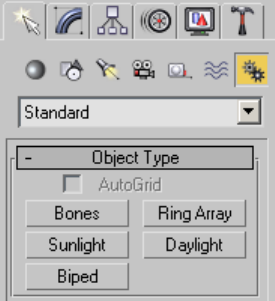
■Bones on page 831 creates a hierarchically linked set of bones and joints.
You can transform and animate bones using both forward and inverse
kinematics. See Animating with Forward Kinematics on page 3279 and
Inverse Kinematics (IK) on page 3299 .
■Ring Array on page 853 creates a ring of boxes.
■Sunlight on page 5024 creates and animates a directional light that follows
the geographically correct angle and movement of the sun over the earth
at a given location.
■Daylight on page 5024 creates an assembly with a sky and a sun. Using the
Get location function you can create and animate a light that follows the
geographically correct angle and movement of the sun over the earth at a
given location.
■Biped on page 4069 creates a two-legged character skeleton designed for
animation.
Systems are primarily intended for plug-in on page 7896 component software.
Additional systems might be available if your configuration includes plug-in
systems.
You can externally reference system objects in your scene. For more
information, see XRef Objects on page 6732 .
Procedures
To create a system:
1On the Create panel, click Systems.
830 | Chapter 6 Creating Geometry
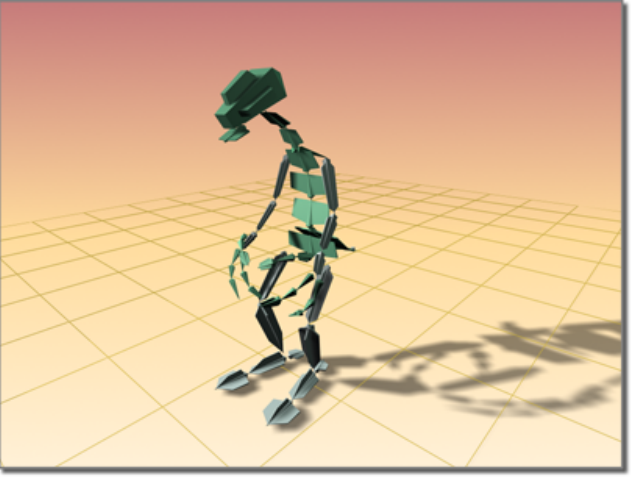
The Systems panel is displayed.
2On the Object Type rollout, choose a system to create.
3Drag in a viewport to create the system.
Bones System
Create panel > Systems > Bones button
Animation menu > Bone Tools > Create Bones
A Bones system is a jointed, hierarchical linkage of bone objects that can be
used to animate other objects or hierarchies. Bones are especially useful for
animating character models that have a continuous skin mesh. You can
animate bones with forward or inverse kinematics. For inverse kinematics,
bones can use any of the available IK solvers on page 3307 , or through
Interactive on page 3383 or applied IK on page 3386 .
Dinosaur character modeled using bones
Bones System | 831

Bones are renderable objects. They have several parameters, such as taper and
fins, that can be used to define the shape the bone represents. The fins make
it easier to see how the bone is rotating.
For animation, it is very important that you understand the structure of a
bone object. The bone's geometry is distinct from its link. Each link has a
pivot point at its base. The bone can rotate about this pivot point. When you
move a child bone, you are really rotating its parent bone.
It might be useful to think of bones as joints, because it is their pivot
placements that matter, more than the actual bone geometry. Think of the
geometry as a visual aid that is drawn lengthwise from the pivot point to the
bone's child object. The child object is usually another bone.
Bones system seen alone and inside a wireframe model
Any hierarchy can display itself as a bone structure (see Using Objects as
Bones on page 843 ), by simply turning on Bone On in the Bone Editing Tools
rollout on page 845 .
See also:
■Bone Tools on page 845
832 | Chapter 6 Creating Geometry

Creating Bones
You start creating bones by clicking the Create Bones button on the Bone
Editing Tools rollout on page 845 , or by clicking the Bones button in the
Systems category on the Create panel.
To create bones, do the following.
1Your first click in a viewport defines the start joint of the first bone.
2The second click in a viewport defines the start joint of the next bone.
Visually only one bone is drawn at this point because bones are visual
aids drawn between two pivot points. It is the actual pivot point’s
placement that is important.
3Each subsequent click defines a new bone as a child of the previous bone.
The result of multiple clicks is a single chain of bones.
4Right-click to exit bone creation.
This creates a small “nub” bone at the end of the hierarchy, which is used
when assigning an IK chain. If you are not going to assign an IK chain
to the hierarchy, you can delete the small nub bone.
Creating a simple chain of three bones
3ds Max lets you create a branching hierarchy of bones. To create a branching
hierarchy, such as legs branching from a pelvis, do the following:
1Create a chain of bones, and then right-click to exit bone creation.
Bones System | 833

2Click Bones (or Create Bones) again, and then click the bone where you
want to begin branching. The new chain of bones branches from the
bone you click.
WARNING The behavior of a branching bone hierarchy is not always intuitive.
NOTE You can also use Select And Link on page 3268 to connect one bone hierarchy
to its branches. However, except for this one special case, using Select And Link
with bones is not recommended . To edit an existing bone structure, whether
branching or not, use the Bone Tools on page 845 instead.
Assigning IK Controllers to Bones
By default, bones are not assigned inverse kinematics (IK). Assigning an IK
solver can be done in one of two ways. Typically, you create a bone hierarchy,
then manually assign an IK solver. This allows for very precise control over
where IK chains are defined.
The other way to assign an IK solver is more automatic. When you create
bones, choose IK solver from the list in the IK Chain Assignment rollout, and
then turn on Assign To Children. When you exit bone creation, the chosen
IK solver is automatically applied to the hierarchy. The solver extends from
the first bone in the hierarchy to the last.
For more information about IK, see Introduction to Inverse Kinematics on
page 3299 .
Setting the Initial Position of Bones
When you first create a bones system, the position of the bones is the initial
state. Before you assign an IK solver or method, you can change the initial
state of the bones by moving, rotating, or stretching the bones individually.
Bone Color
By default, bones are assigned the color specified for Bones in the Colors
panel on page 7505 of the Customize User Interface dialog on page 7489 . Choose
Object as the Element and then choose Bones in the list. You can change the
color of individual bones by selecting the bone, clicking the active color swatch
next to the bone’s name in the Create panel or Modify panel, and then
selecting a color in the Object Color dialog on page 327 .
You can also use the Bone Tools on page 845 to assign bone colors, or to assign
a color gradient to a bone hierarchy.
834 | Chapter 6 Creating Geometry
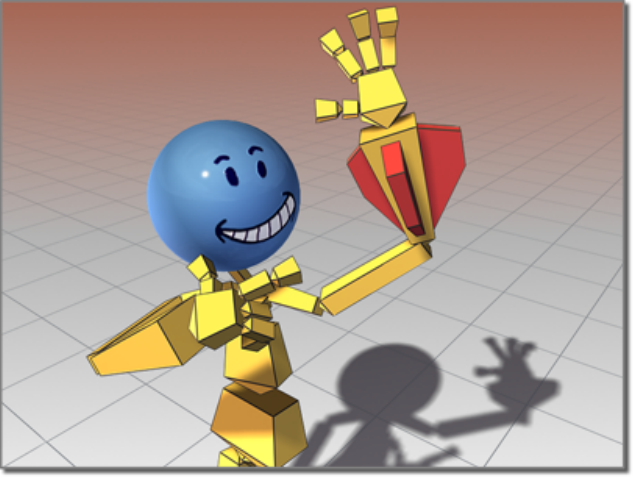
Bone Fins
Fins are visual aids that help you clearly see a bone’s orientation. Fins can also
be used to approximate a character's shape. Bones have three sets of fins: side,
front, and back. By default, fins are turned off.
Bones can have fins.
Bones System | 835

Bones with various fin configurations
Renderable Bones
Bones can be renderable, though by default, they are not. To make a bone
renderable, turn on the Renderable check box in the bone’s Object Properties
dialog on page 245 .
836 | Chapter 6 Creating Geometry

Bones can be renderable.
Object Properties for Bones
In addition to visual properties, bones have behavioral properties. The controls
for these are located on the Bone Tools floater on page 845 .
You can use these controls to turn other kinds of objects into bones.
Using Constraints with Bones
You can apply constraints on page 3212 to bones as long as an IK solver or
method is not controlling the bones. If the bones have an assigned IK
controller, you can constrain only the root of the hierarchy or chain. However,
applying position controllers or constraints to a linked bone can cause
undesirable effects, such as breaking of the bone chain.
Bones System | 837
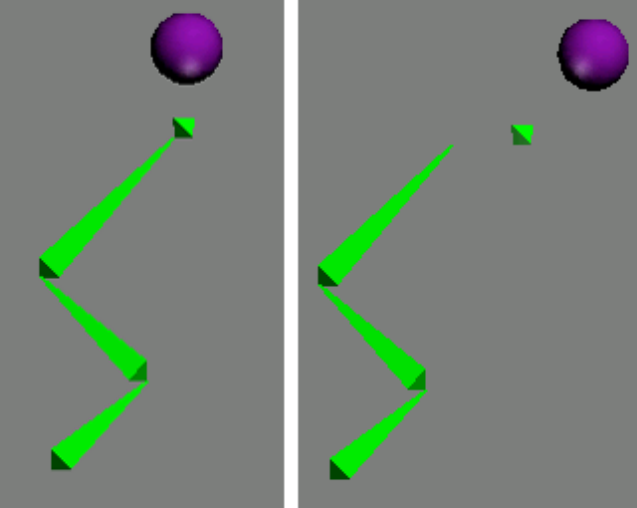
The “nub” bone at the end of the chain has a Spring controller applied to it. The Spring
controller is connected to an animated sphere.
Right: The sphere's movement breaks the bone chain.
To avoid this problem, don't apply position controllers directly to child bones.
Instead, create an IK chain and apply the controller to the IK chain's end
effector.
838 | Chapter 6 Creating Geometry

A IK chain has been applied, connecting the end nub to its parent bone. The IK chain's
end effector is connected to the ball by a Spring controller.
Right: Now when the sphere moves, the IK chain prevents the bones from breaking.
Constraints and controllers that affect orientation only, such as Orientation
or Look At, do not present this problem when applied to child bones.
Procedures
To create a bones system:
1 On the Create panel, click Systems, and then click Bones.
You can also access Create Bones through the Bone Tools rollout.
2Click in a viewport.
This creates a joint that is the base of the bone's hierarchy.
3Drag to define the length of the second bone.
Bones System | 839

4Click to set the length of the second bone, and then drag to create the
third bone. Drag and click to continue creating new bones.
5Right-click to end creation.
3ds Max creates a small “nub” bone at the end of the hierarchy. This
bone is used when assigning an IK chain.
The first bone you create is at the top of the hierarchy. The last bone you
create is at the bottom. For more about linked objects, see the Hierarchy
Panel on page 7453 .
To create a bones hierarchy with an IK solver automatically applied:
1 In the Create panel, click Systems, and then click Bones.
2In the IK Chain Assignment rollout, select an IK solver from the list.
3Turn on Assign To Children.
4In a viewport, click and drag to create the bones. Right-click to end bone
creation.
After the bones are created, the chosen IK solver is applied to them.
To edit the appearance of a bone:
1Select a bone.
2 Click the Modify tab on the command panel.
3Change settings in the Bone Parameters rollout.
To change the length of bones after they’ve been created:
IMPORTANT Repositioning a bone affects its length visually. More importantly,
it affects the bone’s pivot position. The length of the bone is only a visual aid
drawn between each bone’s pivot point. A bone has only one pivot. The bone
you see visually is connecting its pivot point to the next bone’s pivot point.
1Choose Animation menu > Bone Tools.
2On the Bone Tools dialog, click Bone Edit Mode.
3Move the child of the bone you want to change. The length of its
immediate parent changes to reach the child bone.
840 | Chapter 6 Creating Geometry

4Turn off Bone Edit Mode when you are finished editing the bones.
To add fins to bones:
1Select the bone.
2Choose Animation menu > Bone Tools.
3Select the bones to which you want to add fins.
4In the Fin Adjustment Tools rollout, turn on Side Fins, Front Fin or Back
Fin.
5Adjust the size and appearance of the fins with the appropriate spinners.
NOTE You can also add fins to an individual bone on the Modify panel.
Interface
IK Chain Assignment rollout (creation time only)
Provides the tools to quickly create a bone chain with an IK solver
automatically applied. Also allows for bone creation with no IK solver.
IK Solver drop-down list Specifies the type of IK solver to be automatically
applied if Assign To Children is turned on.
Assign To Children When on, assigns the IK solver named in the IK solver
list to all the newly created bones except the first (root) bone. When off,
assigns a standard PRS Transform controller on page 3145 to the bones.
Default=off.
Bones System | 841

NOTE Choosing the SplineIKSolver and turning on Assign To Children causes the
Spline IK Solver dialog on page 3376 to appear after bones have been created.
Assign To Root When on, assigns an IK solver to all the newly created bones
including the first (root) bone.
Turning on Assign To Children also automatically turns on Assign To Root.
Bone Parameters rollout (creation and modification time)
These controls change the appearance of the bones.
842 | Chapter 6 Creating Geometry
Bone Object group
Width Sets the width of the bone to be made.
Height Sets the height of the bone to be made.
Taper Adjusts the taper of the bone shape. A Taper of 0 produces a
box-shaped bone.
Bone Fins group
Side Fins Lets you add a set of fins to the sides of the bones you create.
■Size Controls the size of the fin.
■Start Taper Controls the start taper of the fin.
■End Taper Controls the end taper of the fin.
Front Fin Lets you add a fin to the front of the bone you create.
■Size Controls the size of the fin.
■Start Taper Controls the start taper of the fin.
■End Taper Controls the end taper of the fin.
Back Fin Lets you add a fin to the back of the bone you create.
■Size Controls the size of the fin.
■Start Taper Controls the start taper of the fin.
■End Taper Controls the end taper of the fin.
Generate Mapping Coords Creates mapping coordinates on the bones. Since
the bones are renderable, they can also have materials applied, which can use
these mapping coordinates.
Using Objects as Bones
Select a linked object or multiple objects linked to each other. > Animation
menu > Bone Tools > Object Properties rollout > Bone On toggle
Bones System | 843

You can use arbitrary objects such as cylinders or boxes as bones, controlling
their animation as if they were bones in a bones system on page 831 . You can
apply an IK solver on page 3307 to the boned objects.
To use objects as bones, select them and then turn on the Bone On toggle on
the Object Properties rollout of the Bone Tools dialog on page 845 .
WARNING Turning on Freeze Length has no visible effect unless you transform
the child of the object to which Freeze Length is applied.
Once you've set objects to function as bones, applying an IK solution behaves
as it does for standard bone objects. The geometry of the boned objects can
stretch or squash during animation.
Procedures
To use objects as bones:
1 Link the objects you want to display as bones.
2 Select all of these objects.
NOTE You can set a single object to work as a bone, but this doesn't have
much use.
3Choose Animation menu > Bone Tools.
The floating Bone Tools dialog is displayed.
4On the Object Properties rollout, turn on Bone On.
3ds Max now treats the selected objects as bones.
5 Select the object to use as the start of the IK chain.
6Choose Animation > IK Solvers > HI Solver.
You can choose a different IK solver, but the HI Solver is the preferred
choice.
7Click to select the end of the IK chain.
Now when you transform the boned objects, their movement is governed
by the IK solver.
844 | Chapter 6 Creating Geometry
Bone Tools
Animation menu > Bone Tools
This command opens the Bone Tools floater, which provides functions for
working with bones. The floater contains three rollouts, described in these
topics:
Bone Editing Tools Rollout on page 845
Fin Adjustment Tools Rollout on page 849
Object Properties Rollout (Bone Tools) on page 851
Bone Tools Rollouts
Bone Editing Tools Rollout
Animation menu > Bone Tools > Bone Tools floater > Bone Editing Tools
rollout
Controls on the Bone Editing Tools rollout let you create and modify bone
geometry and structure, and set bone color for one or more bones.
See also:
■Bones System on page 831
Bones System | 845

Interface
Bone Pivot Position group
Bone Edit Mode Lets you change the lengths of bones and their positions
relative to one another.
When this button is on, you can change the length of a bone by moving its
child bone. In effect, you can scale or stretch a bone by moving its child bone
while in this mode. You can use this tool both before and after assigning an
IK chain to the bone structure.
When Bone Edit Mode is on, you cannot animate, and when Auto Key or Set
Key is on, Bone Edit Mode is unavailable. Turn off Auto/Set Key to edit bones.
NOTE Moving a bone in Bone Edit mode affects the length of both the child and
its parent . If the bones aren't spatially aligned in the usual way (for example, if
you are using other objects as bones), this might have unexpected results.
846 | Chapter 6 Creating Geometry
Bone Tools group
Create Bones Begins the bone-creation process. Clicking this button is the
same as clicking Create panel > Systems > Bones on page 831 .
Create End Creates a nub bone at the end of the currently selected bone. If
the selected bone is not at the end of a chain, the nub is linked in sequence
between the currently selected bone and the next bone in the chain.
Remove Bone Removes the currently selected bone. The bone’s parent bone
is stretched to reach the removed bone’s pivot point, and any children of the
removed bone are linked to its parent. Any IK chains that included the removed
bone will remain intact.
Connect Bones Creates a connecting bone between the currently selected
bone and another bone. When you click this button, a dotted line appears in
the active viewport from the first selected bone. Move the cursor to another
bone to create a new connecting bone. The first selected bone will become a
parent to the connecting bone, which is in turn a parent to the second selected
bone.
Delete Bone Deletes the currently selected bone, removing all its parent/child
associations. A nub is placed at the end of the deleted bone’s parent. Any IK
chains that included this bone become invalid.
Reassign Root Makes the currently selected bone the root (parent) of the
bone structure.
If the current bone is the root, clicking this has no effect. If the current bone
is the end of the chain, the chain is completely reversed. If the current bone
is in the middle of the chain, the chain becomes a branching hierarchy.
Refine Splits a bone in two. Click Refine, and then click a bone where you
want it to split.
Mirror Opens the Bone Mirror dialog (see following), which lets you create
mirror copies of selected bones without changing the sign of the bones' scale.
Instead, Mirror flips one of the bone axes: Y or Z. You can specify the mirroring
axis and the flip axis with the dialog controls.
Bones System | 847

Bone Mirror Dialog
Opens when you click the Mirror button. Use it to specify the mirroring axis,
the flip axis, and an offset value.
While the dialog is open, you can see a preview of the mirrored bone(s) in the
viewports. Click OK to create the bones, or Cancel to prevent creation.
Mirror Axis Choose an axis or plane about which the bones will be mirrored:
X/Y/Z or XY/YZ/ZX.
Bone Axis to Flip To avoid creating a negative scale, choose the bone axis
to flip: Y or Z.
Offset The distance between the original bones and the mirrored bones. Use
this to move the mirrored bones to the other side of the character.
Bone Coloring group
Selected Bone Color Sets the color for selected bones.
Apply Gradient Applies a gradient color across several bones based on the
Start Color and End Color values. This option is available only when two or
more bones are selected. The Start Color is applied to the highest parent bone
in the selected chain, while the End Color is applied to the last child object
in the selected chain. Intermediate colors in the gradient are applied to bones
in between.
Start Color Sets the starting color for the gradient.
End Color Sets the ending color for the gradient.
848 | Chapter 6 Creating Geometry

Fin Adjustment Tools Rollout
Animation menu > Bone Tools > Bone Tools floater > Fin Adjustment Tools
rollout
Controls on the Fin Adjustment Tools rollout are for adjusting some aspects
of bone geometry, including fins.
Interface
Bones System | 849
Absolute Sets the fin parameters as absolute values. Use this option to set
the same fin values for all selected bones.
Relative Sets the fin parameters relative to their current values. Use this
option to retain size relationships between bones with different-sized fins.
Copy Copies the bone and fin settings for the currently selected bone, in
preparation for pasting to another bone.
Paste Pastes the copied bone and fin settings to the currently selected bone.
Bone Objects group
Width Sets the width of the bone.
Height Sets the height of the bone.
Taper Adjusts the taper of the bone shape. A Taper with a 0 value produces
a box-shaped bone. Higher values pinch the bone where it joins its child bone,
while lower values expand that end of the bone.
Fins group
Side Fins Adds side fins to selected bones.
■Size Controls the size of the fin.
■Start Taper Controls the start taper of the fin.
■End Taper Controls the end taper of the fin.
Front Fin Adds front fins to selected bones.
■Size Controls the size of the fin.
■Start Taper Controls the start taper of the fin.
■End Taper Controls the end taper of the fin.
Back Fin Adds fins to the backs of selected bones.
■Size Controls the size of the fin.
■Start Taper Controls the start taper of the fin.
■End Taper Controls the end taper of the fin.
850 | Chapter 6 Creating Geometry

Object Properties Rollout (Bone Tools)
Animation menu > Bone Tools > Bone Tools floater > Object Properties rollout
Controls on the Object Properties rollout for bones let you turn other objects
into bones. They also control bone rigidity and alignment.
NOTE You can reset the scale of bones with the Reset Scale option.
Interface
Bone On/Off When turned on, the selected bone or object behaves as a
bone. Turning this option off causes the object to stop behaving like a bone:
there is no auto alignment or stretching. Default=on for bone objects, off for
other kinds of objects.
NOTE Turning this option on doesn't immediately cause objects to align or stretch.
However, future transforms of children can cause rotation and stretching.
Freeze Length When turned on, the bone maintains its length. When turned
off, the bone's length is based on the translation of its child bone. This option
is available only if Bone On is on. Default=on.
WARNING When you turn on Freeze Length, this has no visible effect unless you
transform the child of the object to which Freeze Length is applied.
Auto-Align When turned off, the bone's pivot point doesn't align to its child
object. The translation of a child bone will not be converted into rotation of
the parent. Instead, the child is allowed to move away from the parent's X
axis. This option is available only if Bone On is on. Default=on.
Bones System | 851

NOTE Changing the Auto-Align state does not have an immediate visual effect
on the skeleton. It affects future behavior when bones are moved.
Correct Negative Stretch When turned on, any stretching of the bone that
results in a negative scale factor will be corrected to a positive number. This
option is available only if Bone On is on. Default=on.
Realign Causes the bone's X axis to realign and point at the child bone (or
the average pivot of multiple children). Normally this alignment is maintained,
and there is no need to use this option. However, it is possible for the bones
to come out of alignment by turning off Auto-Align and moving a child bone.
Use Realign to align the bone back to its child. This option is available only
if Bone On is on.
Reset Stretch Stretches the bone to reach its child object if the child has
been moved away from the bone. This option is available only if Bone On is
on.
Reset Scale Resets a stretched bone's internally calculated scale to 100% on
each axis. Using this option avoids unexpected behavior due to objects which
are both linked and scaled. This option has no visual effect on the bone. This
option is available only if Bone On is on.
Stretch Factor Information
Under the Correct Negative Stretch options is a text display giving information
about the number of bones selected and the respective stretch factor for all
three axes. If more than one bone is selected, the Stretch Factor text displays
undefined.
NOTE The Stretch Factor text only updates when you are in Bone Edit Mode on
page 845 .
Stretch and Axis Options
Stretch Determines what kind of stretch takes place when the child bone is
transformed and Freeze Length is off. Default=Scale.
■None No stretch takes place.
■Scale Lets the bone scale. The stretch happens along one axis.
■Squash Lets the bone squash. The bone gets fatter as it gets shorter, and
thinner as it gets longer.
852 | Chapter 6 Creating Geometry

Axis Determines the axis used for the stretch.
■X/Y/Z Choose the axis for scaling or squashing.
■Flip Flips the stretch along the selected axis.
Ring Array System
Create panel > Systems > Ring Array button
The Ring Array object consists of a dummy object on page 2531 surrounded
by a ring of boxes. You can arrange the boxes in the ring along a sine curve,
vary their number, and animate the ring array's parameters. You can also
replace the boxes with other objects using Track View, as described in the
Procedures section, below.
Example of ring array
Procedures
To create the ring array system:
1 On the Create panel, click Systems, and then click Ring
Array.
2Drag in a viewport to set the center and radius of the array.
A dummy object appears at the center. By default, four boxes are evenly
spaced in a circle around it.
To animate the ring array:
1 Turn on Auto Key.
2Move to a nonzero frame.
Ring Array System | 853

3Adjust the ring array parameters.
You can't animate the number of boxes in the ring.
4Repeat steps 2 and 3 for additional keyframes.
NOTE To animate the ring array after creation, use the Motion panel, not
the Modify panel.
To put other kinds of objects in the ring:
You can use either version of Track View: Curve Editor or Dope Sheet.
1In the Track View Controller window, click the name of object container
of the object to put in the ring.
The name highlights.
854 | Chapter 6 Creating Geometry
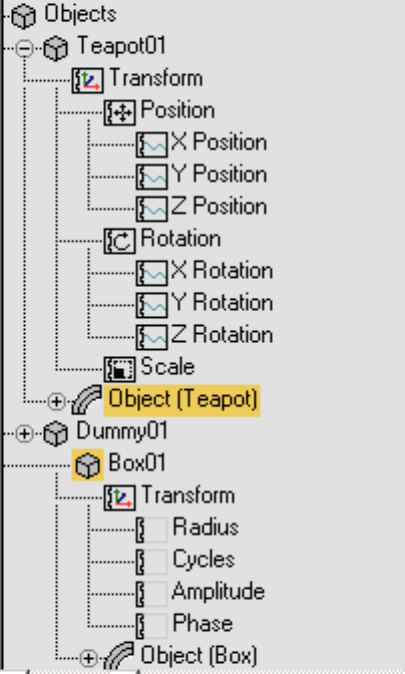
2Still in the Controller window, right-click and choose Copy from the
menu.
3Highlight the object container of one of the ring array boxes.
Ring Array System | 855

4Right-click and choose Paste.
5In the Paste dialog, choose Copy or Instance. Optionally, to replace all
the boxes with the copied object, turn on Replace All Instances. Click
OK.
The box or boxes are replaced with the copied object.
TIP To see the replacement objects, you might need to refresh the viewports.
856 | Chapter 6 Creating Geometry

Top: Object substituted for boxes in array
Bottom: The result
Ring Array System | 857
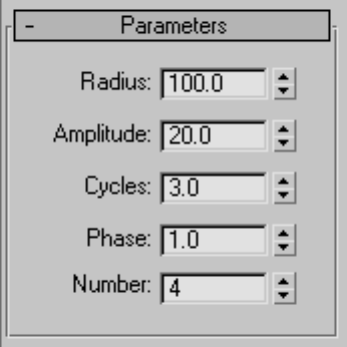
Interface
These parameters control ring arrays. To adjust and animate the ring array
after creation, select one of the array objects (not the dummy), and then go
to the Motion panel, not the Modify panel.
Radius Sets the radius of the ring. You set the initial Radius value when you
drag to create the ring array.
Amplitude Sets the amplitude of the ring's sine curve, in active units.
Amplitude is a height offset from the local origin of the center dummy object.
Cycles Sets the number of cycles in the ring's sine curve. When Cycles is 0.0,
the ring is flat. When Cycles is 1.0, the ring is tilted. Greater values increase
the number of peaks in the curve.
Phase Offsets the phase of the wave. That is, it has the effect of moving the
wave along the circumference of the ring. Whole values have no effect; only
fractional values do.
Number Sets the number of boxes in the ring.
858 | Chapter 6 Creating Geometry

Moving, Rotating, and
Scaling Objects
To change an object’s position, orientation, or scale, click one of the three transform buttons
on the main toolbar or choose a transform from a shortcut menu. Apply the transform to a
selected object using the mouse, the status bar Coordinate Display fields, a type-in dialog, or
any combination of the above.
The column can be moved, rotated, and scaled.
These topics describe how to use and animate transforms, with procedures:
Using Transforms on page 862
7
859
Using Transform Gizmos on page 865
Transform Type-In on page 874
Animating Transforms on page 877
Transform Managers on page 879
Specifying a Reference Coordinate System on page 881
Choosing a Transform Center on page 882
Using the Axis Constraints on page 884
Transform Commands on page 887
Transform Coordinates and Coordinate Center on page 896
Transform Tools on page 909
Scaling and Dimensions
If you scale an object and later check its base parameters in the Modify panel, you see the
dimensions of the object before it was scaled. The base object exists independently of the
scaled object that is visible in your scene.
You can use the Measure utility on page 2597 to measure the current dimensions of an object
that has been scaled or changed by a modifier.
See also:
■Creating Copies and Arrays on page 953
■Using +Clone on page 968
Axis Tripod and World Axis
Two visual aids in 3ds Max give you information about your current orientation
in the workspace.
Axis Tripod
If no transform tool is active, an axis tripod appears in the viewports whenever
you select one or more objects, to assist you visually in your transforms. When
a transform tool is active, the transform gizmo on page 865 appears instead,
unless you've turned it off.
860 | Chapter 7 Moving, Rotating, and Scaling Objects
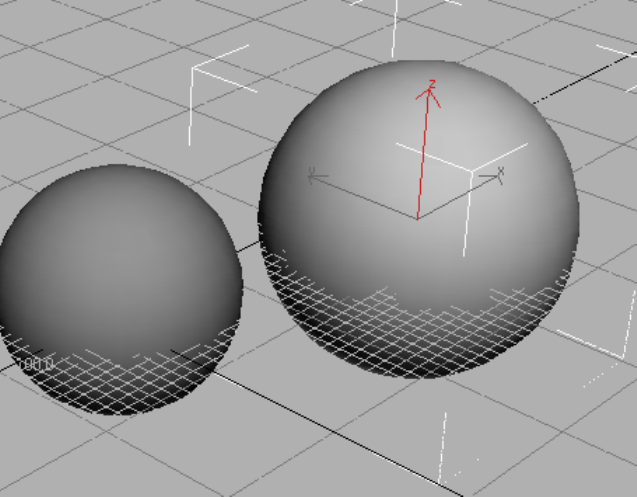
The axis tripod appears when the transform gizmo is inactive.
The axis tripod consists of three lines, labeled X, Y, and Z, and shows you
three things:
■The orientation of the tripod reveals the orientation of the current reference
coordinate system.
■The location of the junction of the three axis lines shows you where your
transform center is.
■The highlighted red axis lines show you the axis or axes to which the
transform is constrained. For example, if only the X axis line is red, you
can move objects only along the X axis.
World Axis
In the lower-left corner of each viewport you can find the world axis, which
shows the current orientation of the viewport with respect to world coordinate
system. The world axis colors are red for X, green for Y, and blue for Z. You
can toggle the display of the world axis in all viewports by turning off Display
Axis Tripod and World Axis | 861
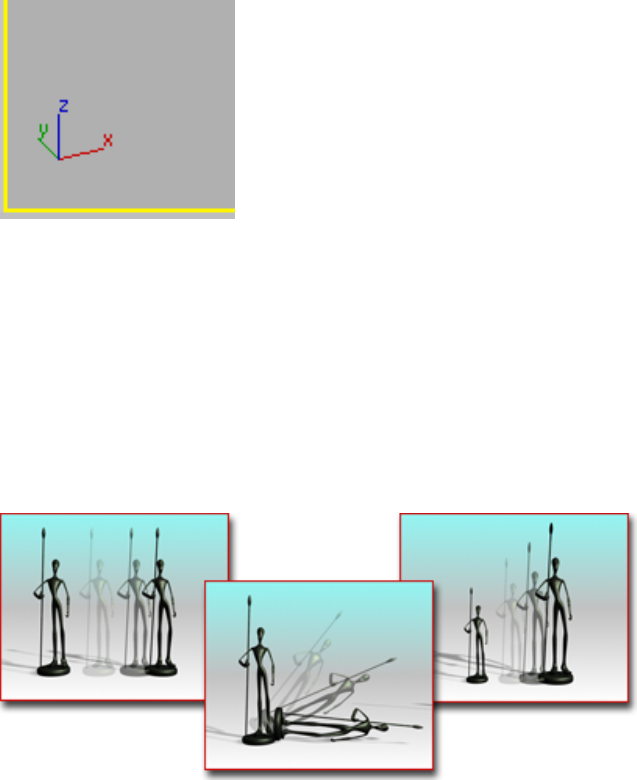
World Axis, on the Viewports panel on page 7545 of the Preference Settings
dialog.
The world axis shows the
current viewport orientation.
See also:
■Using Transform Gizmos on page 865
■Transform Managers on page 879
Using Transforms
Changing a model by changing its position, rotation, or scale
862 | Chapter 7 Moving, Rotating, and Scaling Objects

A transform is an adjustment of an object’s position, orientation, or scale,
relative to the 3D world (or world space) in which you’re working. You can
apply three types of transform to an object:
■Position on page 888
■Rotation on page 889
■Scale on page 891
This section presents these brief topics designed to help you quickly start
learning how to transform objects, and how to animate your transforms:
Using Transform Gizmos on page 865
Animating Transforms on page 877
Transform Managers on page 879
Specifying a Reference Coordinate System on page 881
Choosing a Transform Center on page 882
Using the Axis Constraints on page 884
Failure to Move or Rotate
In some cases, an object might fail to move or rotate, even when the proper
button is on and the object is selected. This could be due to one of the
following reasons:
■The object is frozen. See Selecting Objects on page 131 .
■A transform controller has been assigned to the object. See Animation
Controllers on page 3058 .
■Inverse Kinematics mode is on and the preference called Always Transform
Children of the World is off. See Introduction to Inverse Kinematics (IK)
on page 3299 .
Using Transforms | 863

Procedures
To transform an object using the Main toolbar :
1 On the Main toolbar , click one of the three transform
buttons: Select And Move on page 888 , Select And Rotate on page 889 ,
or Select And Scale on page 891 . These buttons are usually referred to as
Move, Rotate, and Scale.
2Position the mouse over the object you want to transform.
■If the object is already selected, the cursor changes to indicate the
transform.
■If the object is not selected, the cursor changes to a small plus sign to
show that the object can be selected.
3Drag the mouse to apply the transform.
If you drag the mouse over an unselected object, it becomes selected and
is also transformed.
You can use the Transform gizmo to easily restrict transforms to one or
two axes. See Using Transform Gizmos on page 865 .
To cancel a transform:
■Right-click while you’re dragging the mouse.
To transform an object from the quad menu:
1Right-click a selected object. The quad menu on page 7300 lists the three
transforms.
2Choose one of the transforms. The equivalent transform button is selected
on the main toolbar.
3Drag the object to apply the transform.
To use transform type-in:
1Choose Tools menu > Transform Type-In to display the dialog.
2Apply a transform to a selected object.
864 | Chapter 7 Moving, Rotating, and Scaling Objects

3You can do any of the following, switching from one to the other as
required.
■Type a value in an axis field and press Enter to apply the transform
change to the selection.
■Drag a spinner in an axis field to update the selection.
■Drag the object to apply the transform and read the resulting change
in the dialog.
For example, if Move is active, the dialog fields read out both the absolute
and offset positions of the selected object in world space. If no object is
selected, the fields turn gray.
To use transform type-in on the status bar:
1Select an object or a group of objects.
2On the Main toolbar , choose a transform (Move, Rotate, or Scale) to
perform on the objects.
3On the status bar, you can do any of the following, switching from one
to another as required:
■ Type a value in an axis field and press Enter to apply the
transform change to the selection. The Absolute/Offset toggle, to the
right of the X, Y, and Z fields, lets you switch between entering values
that are absolute (in world space) or offset (relative to the selection's
present position, orientation, and dimensions).
■Drag a spinner in an axis field to update the selection.
■Drag the object to apply the transform and read the resulting change
in the X, Y, and Z fields.
TIP To see the Z field, drag the transform type-in portion of the toolbar
while a pan hand is visible.
Using Transform Gizmos
Select an object. > main toolbar > Click any transform button to display the
object’s Transform Gizmo icon.
Using Transform Gizmos | 865

Move gizmo
Rotate gizmo
866 | Chapter 7 Moving, Rotating, and Scaling Objects
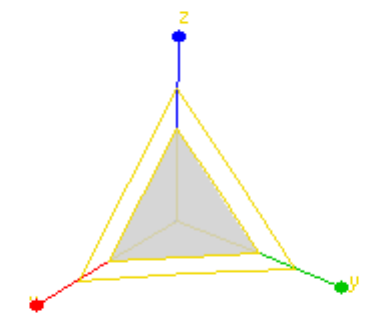
Scale gizmo
The Transform gizmos are viewport icons that let you quickly choose one or
two axes when transforming a selection with the mouse. You choose an axis
by placing the mouse over any axis of the icon, and then drag the mouse to
transform the selection along that axis. In addition, when moving or scaling
an object, you can use other areas of the gizmo to perform transforms along
any two axes simultaneously. Using a gizmo avoids the need to first specify
a transform axis or axes on the Axis Constraints toolbar on page 7288 , and also
lets you switch quickly and easily between different transform axes and planes.
A Transform gizmo appears when one or more objects are selected and one
of the transform buttons ( Select And Move on page 888 , Select And Rotate
on page 889 , or Select And Scale on page 891 ) is active on the main toolbar.
Each transform type uses a different gizmo. By default, each axis is assigned
one of three colors: X is red, Y is green, and Z is blue. The corners of the Move
gizmo are assigned the two colors of the related axes; for example, the corner
for the XZ plane is red and blue.
When you position the mouse over any axis, it turns yellow to indicate that
it’s active. Similarly, position the mouse over one of the plane handles, and
both associated axes turn yellow. You can now drag the selection along the
indicated axis or axes. Doing so changes the Axis Constraints toolbar "Restrict
to ..." setting on page 884 .
Move Gizmo
The Move gizmo includes plane handles, and the option to use a center box
handle.
Using Transform Gizmos | 867
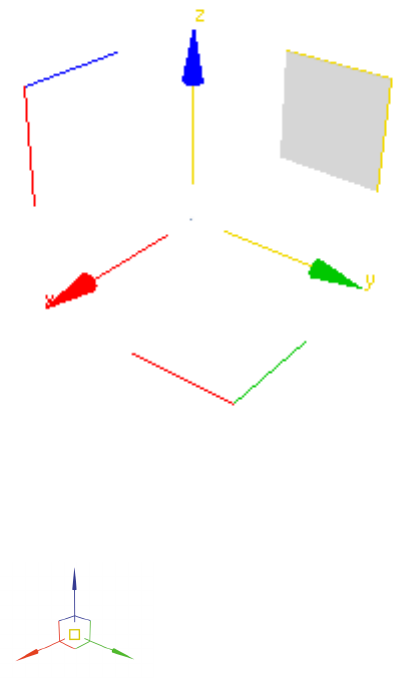
You can select any of the axis handles to constrain movement to that axis. In
addition, the plane handles allow you to constrain movement to the XY, YZ,
or XZ planes. The selection hotspot is within the square formed by the plane
handles. You can change the size and offset of the handles and other settings
on the Gizmos panel on page 7570 of the Preferences dialog on page 7534 .
The Move gizmo with the YZ axes selected.
You can constrain translation to the viewport plane by dragging the center
box. To use this optional control, turn on Move In Screen Space on page 7572
.
Rotate Gizmo
The Rotate gizmo is built around the concept of a virtual trackball. You can
rotate an object freely, about the X, Y, or Z axis, or about an axis perpendicular
to the viewport.
868 | Chapter 7 Moving, Rotating, and Scaling Objects
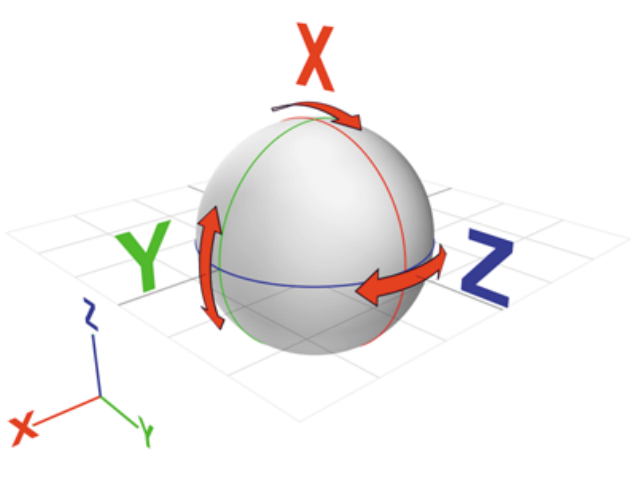
The axis handles are circles around the trackball. Drag anywhere on one of
them to rotate the object about that axis. As you rotate about the X, Y, or Z
axis a transparent slice provides a visual representation of the direction and
amount of rotation. If you rotate more than 360°, the slice overlaps and the
shading becomes increasingly opaque. The software also displays numerical
data to indicate a precise rotational measurement.
Using Transform Gizmos | 869

In addition to XYZ rotation, you can also use free rotation or the viewport
handle to rotate objects.
Drag inside the Rotate gizmo (or the outer edge of the gizmo) to perform free
rotation. Rotation should behave as if you were actually spinning the trackball.
The outermost circle around the Rotate gizmo is the Screen handle, which
lets you rotate the object on a plane parallel to the viewport.
You can adjust settings for the Rotate gizmo on the Gizmos panel on page
7570 of the Preferences dialog on page 7534
Scale Gizmo
The Scale gizmo includes plane handles and scaling feedback through the
stretching of the gizmo itself.
The plane handles let you perform uniform and non-uniform scaling without
changing your selection on the main toolbar:
■To perform Uniform scaling, drag in the center of the gizmo.
870 | Chapter 7 Moving, Rotating, and Scaling Objects
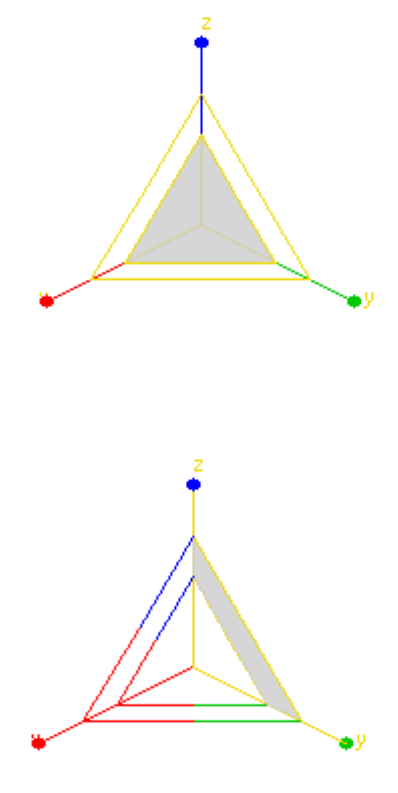
The Transform gizmo with Uniform scaling selected.
■To perform non-uniform scaling, drag on a single axis or a plane handle.
Using Transform Gizmos | 871
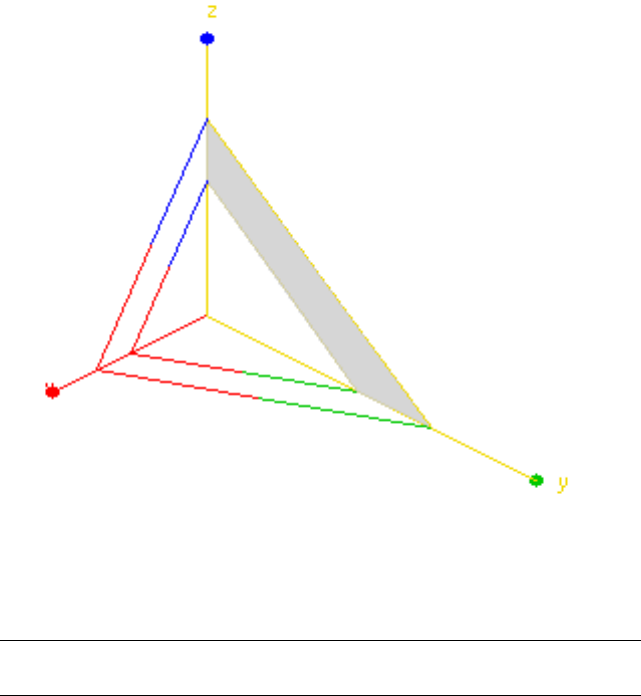
Top: The Scale gizmo with the YZ plane handle selected
Bottom: Non-uniform scaling on the YZ plane
NOTE To perform a Squash operation, you must choose Select and Squash on
page 894 on the main toolbar.
The Scale gizmo provides feedback by changing its size and shape; in the case
of a uniform scale operation, it will grow or shrink as the mouse moves, and
during non-uniform scaling, the gizmo will stretch and deform while dragging.
However, once the mouse button is released, the gizmo returns to its original
size and shape.
You can adjust settings for the Scale gizmo on the Gizmos panel on page 7570
of the Preferences dialog on page 7534
Notes
Using a Transform gizmo sets the default axis constraint to the last axis or
plane you used.
872 | Chapter 7 Moving, Rotating, and Scaling Objects

If Lock Selection Set is on, you can drag anywhere in the viewport to transform
the object. Dragging an axis, however, still applies the constraint along that
axis.
See also:
■Gizmos Preferences on page 7570
Procedures
Example: To explore use of the transform gizmo:
1 Reset the program, then create a sphere, and then click the Select
and Move button.
The Transform gizmo appears at the center of the sphere. Because the
default axis constraint on the Axis Constraints toolbar is XY Plane, the
X and Y shafts of the Transform gizmo are yellow (active), while the Z
shaft is blue.
2 Use Arc Rotate on page 7395 to adjust the Perspective view for a
better view of the Transform gizmo. When you’re done, right-click to
return to Select and Move .
3Point to any part of the sphere away from the Transform gizmo, and drag
to confirm that the sphere is locked to the XY plane.
4Point to the Z-axis shaft, and drag.
The Z shaft turns yellow, the X and Y shafts turn red and green,
respectively, and the sphere moves along the Z axis.
5Point to the Y shaft, and drag.
The Y shaft turns yellow, and the sphere moves along only the Y axis.
6Point to the red-and-green corner mark opposite the ends of the X and
Y axes, and drag.
The sphere moves along the XY plane.
7Press the Spacebar to turn on Selection Lock on page 7324 .
8Drag the mouse anywhere in a viewport away from the selection.
The sphere moves along the XY plane.
Using Transform Gizmos | 873

9Point to the X shaft, and drag.
The sphere moves along only the X axis.
Experiment with other transformations, such as rotation and scale. Try different
reference coordinate systems. Experiment with sub-object transformations.
Interface
Change default colors Customize menu > Customize User Interface dialog
> Colors panel on page 7505 > Gizmos Element > Active Transform Gizmo and
Transform Gizmo X/Y/Z.
Enable/disable Transform Gizmo Customize menu > Preferences > Gizmos
panel on page 7570 > On check box.
NOTE When you turn off the Transform gizmo in Preferences, the standard axis
tripod appears instead. To toggle display of either the gizmo or the tripod, press
the X key or use Views menu > Show Transform Gizmo.
There are additional controls for each Gizmo in the Gizmos panel on page
7570 of the Preferences dialog.
Transform Type-In
Status bar > Transform Type-In
Edit menu > Transform Type-In
F12
Main toolbar > Right-click Select And Move, Select And Rotate, or one of the
Select And Scale buttons.
Transform Type-In is a dialog that lets you enter precise values for move,
rotate, and scale transforms on page 7958 . You can use Transform Type-In with
anything that can display an axis tripod or Transform gizmo.
You can also use the Transform Type-In boxes on the status bar on page 7308
. To use the Transform Type-In boxes on the status bar, simply enter the
appropriate values in the boxes and press Enter to apply the transformation.
You can alternate between entering absolute transform values or offset values
by clicking the Relative/Absolute Transform Type-In button to the left of the
transform boxes.
874 | Chapter 7 Moving, Rotating, and Scaling Objects
If you choose Transform Type-In from the Edit menu, press F12, or right-click
one of the transform toolbar buttons, Transform Type-In pops up as a dialog.
The title of the dialog reflects the active transform. If Rotate is active, the
dialog's title is Rotate Transform Type-In and its controls affect rotation. If
Scale is active, its title is Scale Transform Type-In, and so on. You can enter
either absolute transform values or offset values.
In most cases, both absolute and offset transforms use the active reference
coordinate system on page 896 . The exceptions are View, which uses the World
coordinate system, and Screen, which uses World for absolute moves and
rotations. Also, absolute scaling always uses the Local coordinate system. The
dialog labels change to show the reference coordinate system being used.
When you use the Transform Type-In at a sub-object level, you transform the
transform gizmo of the sub-object selection. So, for example, the absolute
position values represent the absolute world position of the transform gizmo.
If you've selected a single vertex, it's the absolute world position of the vertex.
If multiple vertices are selected, the Transform gizmo is placed at the center
of the selection, so the position you specify in the Transform Type-In sets the
absolute position of the center of the selected vertices.
When multiple vertices are selected in Local transform mode, you end up with
multiple transform gizmos. In this case, only the Offset control is available.
Because the axis tripods are not scaled, the Absolute Scale control is not
available at the sub-object level. Only Offset is available.
When you use the Transform Type-In for Absolute rotation, the state of the
Center flyout is respected. You can perform absolute rotations about the pivot
point of the object, the selection center, or transform coordinate center. See
Choosing a Transform Center on page 882 .
Using Type-In with Sub-Object Selection
You can use Transform Type-In with any sub-object selection or gizmo. The
transform affects the axis tripod for the selection.
Absolute and offset world coordinates are those of the object's or selection's
coordinate system, whose origin is indicated by the axis tripod. If multiple
vertices are selected, the tripod is at the center of the selection and its location
is given in world coordinates.
Because axis tripods cannot be scaled, Absolute Scale fields are unavailable
when you are at a sub-object level.
See Basics of Creating and Modifying Objects on page 317 for information on
sub-object selection and gizmos.
Transform Type-In | 875

Procedures
To use transform type-in:
1Select an object or a group of objects.
2Choose a transform to perform on the objects (Move, Rotate, or Scale).
3You can do any of the following, switching from one to another as
required:
■Type a value in an axis field and press Enter to apply the transform
change to the object in the viewport.
■Drag a spinner in an axis field to update the object in the viewport.
■Drag the object to apply the transform and read the resulting change
in the axis fields.
For example, if Move is active, the fields read out both the absolute
positions of the selected object in world space. If no object is selected,
the fields turn gray.
Interface
Status bar
Absolute/Offset Mode Transform Type-In When this is off, the
software treats values you enter into the X, Y, and Z fields as absolutes. When
this is on, the software applies transform values you enter as relative to current
values; that is, as an offset. Default=off.
X, Y, and Z Display and accept entry for values of position, rotation, and
scale along each axis.
Absolute group (Dialog)
876 | Chapter 7 Moving, Rotating, and Scaling Objects

X, Y, and Z Display and accept entry for absolute values of position, rotation,
and scale along each axis. Position and rotation are always displayed, as world
scale is always local.
Offset group (Dialog)
X, Y, and Z Display and accept entry for offsets of the position, rotation,
and scale values along each axis.
Displayed offset values revert to 0.0 after each operation. For example, if you
enter 45 degrees in a Rotate Offset field, when you press Enter, the software
rotates the object 45 degrees from its previous position, increases the Absolute
field value by 45 degrees, and resets the Offset field to 0.0.
Offset labels reflect the active reference coordinate system. The Offset can be
Offset: Local, Offset: Parent, and so on. If you use Pick to select the reference
coordinate system of a particular object, the Offset will be named with that
object.
Animating Transforms
You can animate changes in position, rotation, and scale (transforms) by
turning on the Auto Key button and then performing the transform at any
frame other than frame 0. This creates a key for that transform at the current
frame.
Example: To animate an object moving among three points:
1 Turn on the Auto Key button on page 3007 .
The Auto Key button and the highlight border around the active viewport
both turn red.
2Drag the time slider to frame 25.
3Move the object from its current position (point A) to another location
(point B).
The software creates Move keys at frames 0 and 25. These appear on the
track bar on page 7315 . The establishing key at frame 0 describes the object’s
original position, at point A. The key at frame 25 describes the object’s
position at point B.
4Drag the time slider to frame 50.
Animating Transforms | 877

5Move the object from point B to a third location (point C).
The software creates a Move key at frame 50 that describes the object’s
position at point C.
6Click the Auto Key button to stop recording.
7 Click the Play button on page 7355 .
The object moves from point A to point B over frames 0 to 25, and then
proceeds to point C over frames 26 to 50.
8 The Play button has turned into a Stop button; click Stop to stop
playback.
You can combine different transforms in a single animation sequence, so that
an object appears to move as it rotates and changes in size.
See Animation Concepts and Methods on page 3002 for more information on
animation techniques.
An object animated among three points
878 | Chapter 7 Moving, Rotating, and Scaling Objects

Transform Managers
3ds Max provides three controls, collectively referred to as the transform
managers, for modifying the action of the transform tools.
The transform manager controls are as follows:
■The Reference Coordinate System drop-down list on page 896 , which
controls the orientation of the transform axes, is found to the right of the
Move, Rotate, and Scale transform buttons on the main toolbar.
■The Transform Center flyout on page 904 , which controls the center about
which the software applies the transform, is found to the right of the
Reference Coordinate System drop-down list.
■The Axis Constraint setting on page 884 lets you restrict the transform to
a single axis or two axes (that is, a plane). The axis constraint tools appear
on the Axis Constraints toolbar, which is off by default. You can open the
toolbar by right-clicking an empty spot on the main toolbar and choosing
Axis Constraints from the menu.
TIP You can also restrict transforms with the transform gizmos on page 865 .
Definitions
Certain terms are used in the description of transforms and the transform
managers.
■An axis is a straight line along which an object is moved or scaled, or about
which an object is rotated. When you work in 3D, you use three axes,
labeled X, Y, and Z, which are oriented 90 degrees from each other.
■A coordinate system specifies the orientation of the X, Y, and Z axes used
by a transform.
For example, in the World coordinate system, as seen from the Front view,
the X axis runs horizontally from left to right, the Y axis runs from back
to front, and the Z axis runs vertically, from bottom to top.
On the other hand, each object carries its own Local coordinate system.
If the object has been rotated, its Local coordinate system might be different
from the world coordinate system.
■The transform center, or pivot point, is the spot about which a rotation takes
place, or to and from which scaling occurs.
Transform Managers | 879

Using the transform managers, you can specify any combination of axes,
transform coordinate systems, and transform centers.
Axis Tripod Icon
■An axis tripod appears in the viewports when you select one or more
objects, to assist you visually in your transforms. This tripod consists of
three lines, labeled X, Y, and Z, and shows you three things:
■The orientation of the tripod reveals the orientation of your coordinate
system.
■The location of the junction of the three axis lines shows you where your
transform center is.
■The highlighted red axis lines show you the axis or axes to which the
transform is constrained. For example, if only the X axis line is red, you
can move objects only along the X axis.
NOTE The Transform gizmo supplants the axis tripod for selections when a
transform mode is active. Besides providing all of the above functions, it lets
you specify the transform axis or axes without explicitly setting constraints;
see Using the Axis Constraints on page 884 . For more on the Transform gizmo,
see Using Transform Gizmos on page 865 .
You can toggle the display of the axis tripod in all viewports by choosing
Views menu > Show Transform Gizmo, or by pressing the X key.
Transform Manager Settings
The state of the three transform managers (coordinate system, center, and
axis constraints) is stored with each type of transform. When you switch from
Move to Rotate to Scale, the transform managers change to whatever
combination they were in when you last used that transform.
For example, if you click Rotate and set the transform managers to Local,
Selection Center, and Y constraint, when you click Move, the controls might
shift to View, Pivot Point, and XY constraint (whichever combination was set
the last time you used Move). When you go back to Rotate, the controls revert
to Local, Selection Center, and Y constraint.
880 | Chapter 7 Moving, Rotating, and Scaling Objects
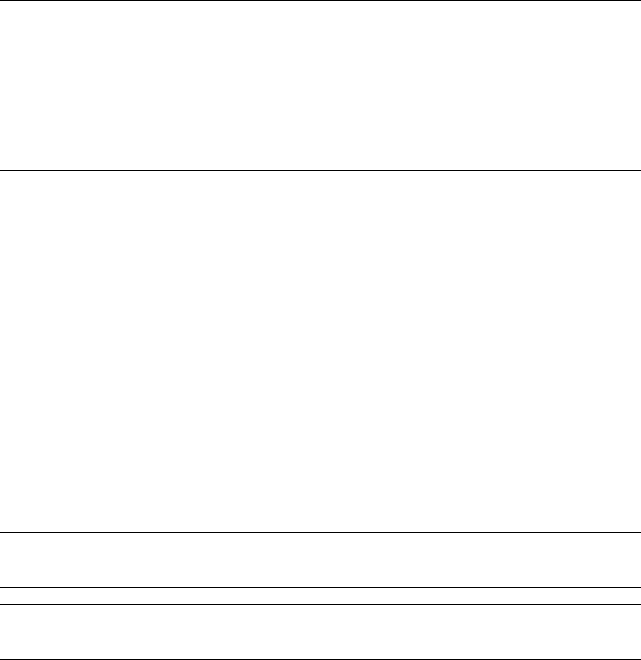
TIP To avoid surprises, always click the transform button first, and then set the
transform managers. If, instead, you first set the transform managers, their settings
are likely to change as soon as you choose a new transform button. One way to
remember this is always to set the transform and managers by working from left
to right on the toolbar. Alternatively, you can turn on Customize menu >
Preferences > General tab > Reference Coordinate System group > Constant, which
keeps the transform manager settings the same for all transforms.
Specifying a Reference Coordinate System
The reference coordinate system determines the orientation of the X, Y, and
Z axes used by the transform. The type of transform system you use affects all
transform operations.
You specify the transform coordinate system using the Reference Coordinate
System list on page 896 .
Creating a Local Axis
While modeling, it’s often helpful to have a temporary, movable local axis so
you can rotate or scale about an arbitrary center.
NOTE This technique does not work for animation. See Choosing a Transform
Center on page 882 for animation tips.
TIP As an alternative to this method, you can use the Working Pivot on page 3402
.
To create an adjustable local axis:
1Create a Point helper object on page 2544 .
2From the Transform Coordinate System list, choose Pick, and then click
the point object.
The name of the point object appears in the list as the active coordinate
system.
Now you can use the point object’s coordinate system as an adjustable axis.
Specifying a Reference Coordinate System | 881
To use the adjustable axis:
1Place the point object where you want the rotate or scale transform to
be centered.
2Select the object you want to transform.
3Choose the point object’s name in the Transform Coordinate System
drop-down list.
4From the Use Center flyout on page 904 choose Use Transform Coordinate
Center. For more information, see Choosing a Transform Center on page
882 .
5Proceed with the transform.
Choosing a Transform Center
The transform center affects scale and rotation transforms, but has no effect
on position transforms.
The software lets you choose from three types of transform center using the
Use Center flyout on page 904 on the main toolbar . When you change the
transform center, the junction of the axis tripod icon moves to the location
you specify.
By default, 3ds Max sets the transform center to Use Pivot Point center for
single objects. When you select multiple objects, the default transform center
changes to Use Selection Center, because selection sets have no pivot point.
You can change the transform center in either case, and the program
remembers and restores the transform center setting separately for selections
of single and multiple objects (during the current session).
For example, you might select a single object and choose Use Transform
Coordinate Center, and then select multiple objects and choose Use Pivot
Point Center. When you next select a single object, the program switches back
to Use Transform Coordinate Center. Then, when you select multiple objects,
the center switches back to Pivot Point.
882 | Chapter 7 Moving, Rotating, and Scaling Objects
1. User selects single object.
2. User clicks Use Transform Coordinate Center from Use Center flyout on Main toolbar.
3. User adds second object to selection.
4. Transform center changes to Use Selection Center when selection set contains more
than one object.
5. User clicks Use Pivot Point Center while multiple objects still selected.
6. User selects single object.
7. Transform center returns to Use Transform Coordinate Center (see step 2).
8. User selects multiple objects.
9. Transform center returns to Use Pivot Point Center (see step 5).
Transforming About Snapped Points
While the transform center choices are often useful at the object level, they
are not usually convenient when transforming sub-object selections. You can
override the active transform center and perform the current transform about
a temporary point by using snaps. When Snaps is active, and your selection
is locked, the point you snap to will set the point about which the transform
is performed. Using this technique, you can:
■Move relative to two snap points.
■Rotate about a snapped point.
■Scale about a snapped point.
For more details, see Snap Settings on page 2578 .
Animation and the Transform Center
Because of the nature of keyframing, you can animate rotation and scale
transforms properly only by using an object’s local pivot point. For example,
while modeling, you can rotate an object that’s offset from the world origin
around the world center coordinate system. The object sweeps around the
origin in a large arc. However, if you attempt to animate this, the object rotates
about its local axis and moves in a straight line from one end of the arc to the
other.
To avoid this discrepancy, if the Auto Key button is on and either the Rotate
or Scale button is active, the Use Center flyout is unavailable and set to Use
Pivot Point. When the Auto Key button is off, all transforms use the center
settings previously described.
Choosing a Transform Center | 883

You can override this behavior by turning off Local Center During Animate
on page 7567 in the Animation Preferences settings.
Keep in mind that this affects only the center of the transform. The orientation
of the selected transform coordinate system is still in effect.
Animating "Off-Center"
You can animate a rotation or scale about an off-center point by linking your
object as the child of a dummy helper object, and then rotating or scaling the
dummy.
Another technique is to offset the pivot point of your object using the
Hierarchy panel.
For information about linking, dummy objects, and the Hierarchy panel, see
Hierarchies on page 3256 .
Using the Axis Constraints
Axis Constraints toolbar > Restrict to X, Y, Z, or a plane
Keyboard >
F5 restricts to X
F6 restricts to Y
F7 restricts to Z
F8 cycles through the three plane restrictions
The Restrict to ... buttons, also called the Axis Constraint buttons, are located
on the Axis Constraints toolbar on page 7288 , which is off by default. You can
turn it on by right-clicking an empty spot on the main toolbar and choosing
Axis Constraints from the pop-up menu. These buttons let you specify one
or two axes about or along which the transform takes place. They help you
avoid transforming an object in a direction you didn't intend.
NOTE It's generally easier to use the Transform gizmos than these buttons; see
Using Transform Gizmos on page 865 . However, it is helpful to understand the
concepts explained below.
884 | Chapter 7 Moving, Rotating, and Scaling Objects
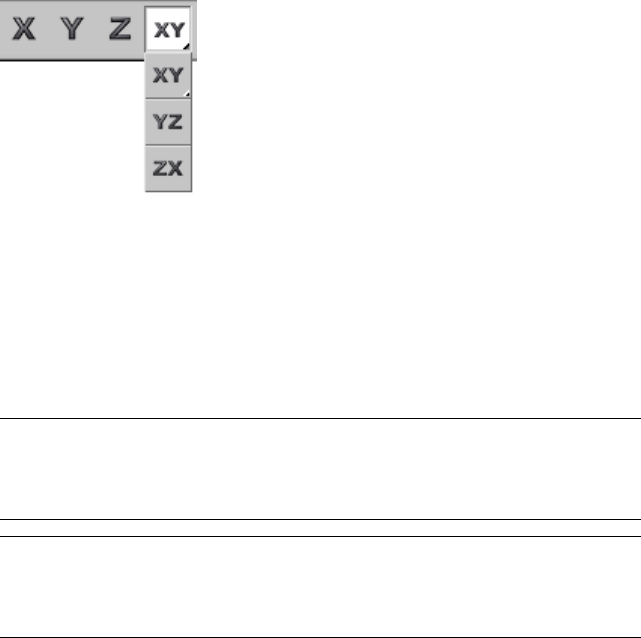
Axis Constraint buttons
Only one axis constraint can be active at a time. When a button is turned on,
transforms are constrained to the specified axis (or plane). For example, if you
turn on the Restrict To X button, you can rotate an object only about the X
axis of the current transform coordinate system.
The axis or axes to which you’re constrained are highlighted in red on the
axis tripod icon in viewports, or in yellow on the Transform gizmo.
NOTE By default, axis constraints don't apply when using Snap. You can override
this by turning on Snaps Use Axis Constraint Toggle on the Axis Constraints
toolbar on page 7288 , or by turning on Use Axis Constraints in Snap Options on
page 2587 .
NOTE Constraints are set on a transform-by-transform basis, so select the transform
before you select the axis constraint. If you do not want the constraints to change,
turn on Customize menu > Preferences > General tab > Reference Coordinate
System group > Constant.
The axis constraints are stored separately at object and sub-object levels. If
you set these three controls one way while in sub-object mode and another
way while in object selection level, when you return to sub-object mode,
they're restored to the way they were previously set. For example, if you're
using XY constraints at object level, then switch to sub-object level and use
Z constraint, when you return to object level, XY will be restored.
Using the Axis Constraints | 885

Restrict to Plane Flyout
The Restrict To Plane flyout, available from the Axis Constraints toolbar, lets
you limit all transformations (move, rotate, scale) to the XY, YZ, or ZX planes
(by default, parallel with the Top view).
You can also select planar constraint by using the Move Transform Gizmo
on page 865 . Instead of dragging one of the axis indicators, drag one of the
plane indicators near the center of the gizmo.
When you move an object along a plane that is head-on to your view, the
object moves along the single available axis shown in the view.
Reset Transform Utility
Utilities panel > Utilities rollout > Reset XForm button
Use the Reset Transform utility to push object rotation and scaling values onto
the modifier stack and align object pivot points and bounding boxes with the
World coordinate system. Reset Transform removes all Rotation and Scale
values from selected objects and places those transforms in an XForm modifier.
To reset the transform of a group, use the Transform button in the Reset group
box of the Hierarchy > Pivot command panel.
Procedures
To reset an object's transform:
1Select an object.
2On the Utilities panel, click Reset XForm.
3On the Utilities panel > Utilities rollout, click the More button and choose
Reset XForm.
886 | Chapter 7 Moving, Rotating, and Scaling Objects
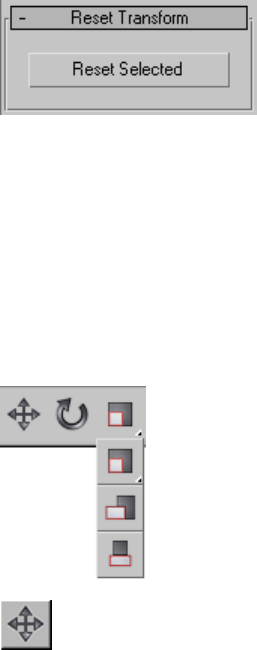
4On the Reset Transform rollout, click Reset Selected.
Object rotation and scaling are now carried by an XForm modifier placed
at the top of the modifier stack.
When you apply the Reset Transform utility, an XForm modifier on page
1922 that carries the rotation and scale values is placed at the top of the
Modifier Stack display. You can apply other modifiers above and below
the XForm modifier. You can select the XForm modifier and add other
Move, Rotate, and Scale transforms. You can delete the XForm modifier
to completely remove the transforms from the object. You can collapse
the object to absorb the rotation and scale values into the object mesh.
Interface
Reset selected Removes all Rotation and Scale values from selected objects
and places those transforms in an XForm modifier.
Transform Commands
The basic transform commands are the most straightforward way to change
an object's position, rotation, or scale. These commands appear on the default
main toolbar on page 7284 . They are also available from the default quad
menu on page 7300 .
Select and Move on page 888
Transform Commands | 887
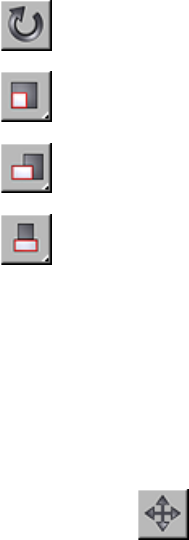
Select and Rotate on page 889
Select and Uniform Scale on page 892
Select and Non-Uniform Scale on page 893
Select and Squash on page 894
See also:
■Moving, Rotating, and Scaling Objects on page 859
■Using +Clone on page 968
■Transform Type-In on page 874
Select and Move
Main toolbar > Select and Move
Right-click an object. > quad menu > Transform quadrant > Move
Edit menu > Select and Move
Use the Select And Move button or the Move command on the Edit or quad
menu to select and move objects.
To move a single object, you do not need to select it first. When this button
is active, clicking an object selects it and dragging the mouse moves it.
The direction of the movement is determined both by your mouse and by the
current reference coordinate system. To restrict object movement to the X, Y,
or Z axis, or to any two axes, click the appropriate button on the Axis
Constraints toolbar on page 7288 , use the Transform gizmo on page 865 , or
right-click the object, and select the constraint from the Transform submenu.
888 | Chapter 7 Moving, Rotating, and Scaling Objects
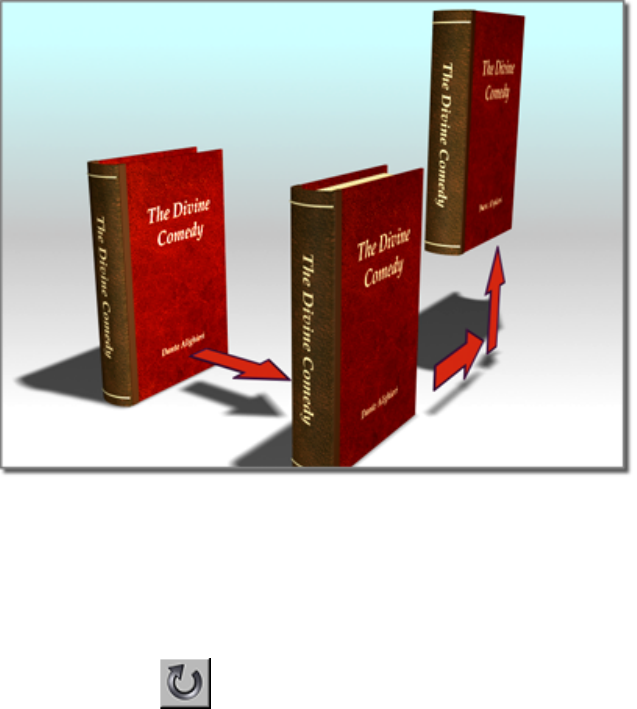
Moving an object
See also:
■Move Gizmo on page 867
Select and Rotate
Main toolbar > Select and Rotate
Right-click an object. > quad menu > Transform quadrant > Rotate
Edit menu > Select and Rotate
Use the Select and Rotate button or the Rotate command on the Edit or quad
menu to select and rotate objects.
To rotate a single object, you don't need to select it first. When this button is
active, clicking an object selects it and dragging the mouse rotates it.
Select and Rotate | 889

When you are rotating an object about a single axis (as is usually the case),
don't rotate the mouse, expecting the object to follow the mouse movement.
Just move the mouse straight up and straight down. Up rotates the object one
way, down rotates it the opposite way.
The center of rotation is determined by the Transform Center setting on page
896 .
To restrict rotation about the X, Y, or Z axis, or to any two axes, click the
appropriate button on the Axis Constraints toolbar on page 7288 , use the
Transform gizmo on page 865 , or right-click the object, and select the
constraint from the Transform submenu.
Rotating an object
See also:
■Rotate Gizmo on page 868
Procedures
This procedure illustrates the intuitive usage of the default Euler XYZ rotation
controller on page 3076 .
890 | Chapter 7 Moving, Rotating, and Scaling Objects
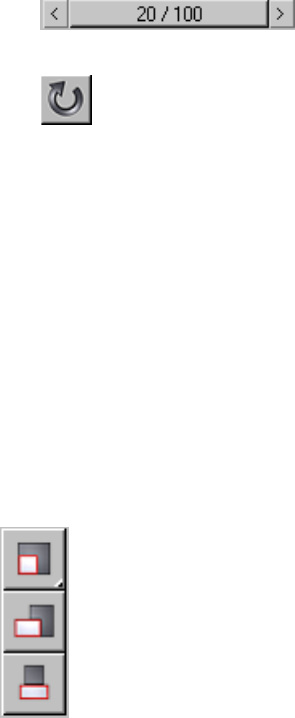
To animate object rotation interactively:
1Add an object.
2 Move the time slider on page 7312 to a
frame other than 0 and turn on Auto Key on page 7344 .
3 Choose Select And Rotate.
4Rotate the object on any axis by any amount.
5Move the time slider to a later frame.
6Rotate the object on the same axis by an amount greater than 180 degrees.
7Play back the animation.
The rotation plays back exactly as you recorded it.
Select and Scale
Main toolbar > Select and Scale flyout
Right-click an object. > quad menu > Transform quadrant > Scale
Edit menu > Select and Scale
The Select And Scale flyout on the main toolbar provides access to three tools
you can use to change object size. These are, from top to bottom:
Select and Uniform Scale on page 892
Select and Non-Uniform Scale on page 893
Select and Squash on page 894
Select and Scale | 891

In addition, the Scale command is available on the Edit menu and the
Transform quadrant of the quad (right-click) menu; this activates whichever
scale tool is currently chosen in the flyout.
NOTE The Smart Scale command activates the Select And Scale function and,
with repeated invocations, cycles through the available scaling methods. By default,
Smart Scale is assigned to the R key; you can use Customize User Interface on
page 7489 to assign it to a different keyboard shortcut, a menu, etc.
Select and Uniform Scale
Main toolbar > Select and Uniform Scale (on Select And Scale flyout)
Right-click an object. > Scale (selects current toolbar Scale mode)
The Select And Uniform Scale button, available from the Select And Scale
flyout on page 891 , lets you scale objects by the same amount along all three
axes, maintaining the object's original proportions.
Uniform scale does not change an object's proportions.
892 | Chapter 7 Moving, Rotating, and Scaling Objects
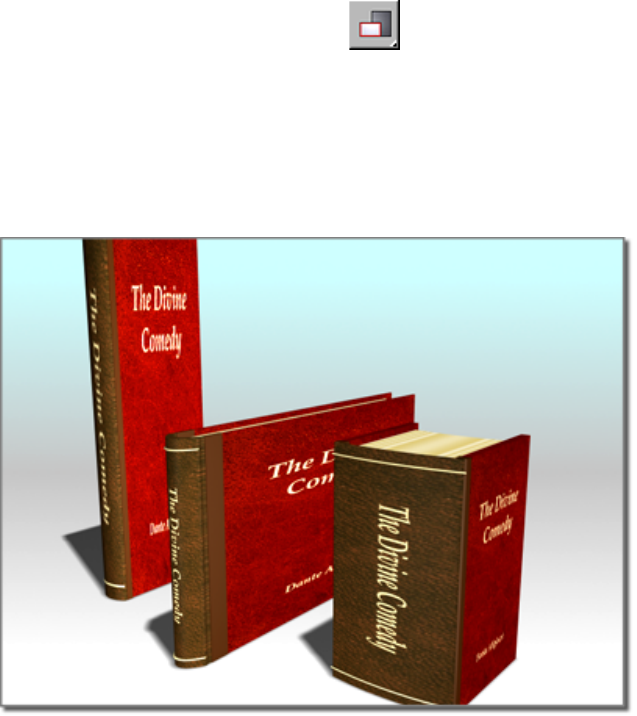
To scale a single object, you don't need to select it first. When this tool is
active, clicking an object selects it and dragging the mouse scales it.
See also:
■Scale Gizmo on page 870
Select and Non-Uniform Scale
Main toolbar > Select and Non-Uniform Scale (on Select And Scale flyout)
Right-click an object. > Scale (selects current toolbar Scale mode)
The Select And Non-Uniform Scale button, available from the Select And
Scale flyout on page 891 , lets you scale objects in a non-uniform manner
according to the active axis constraint.
Non-uniform scale can change proportions with different values for different axes.
Select and Non-Uniform Scale | 893
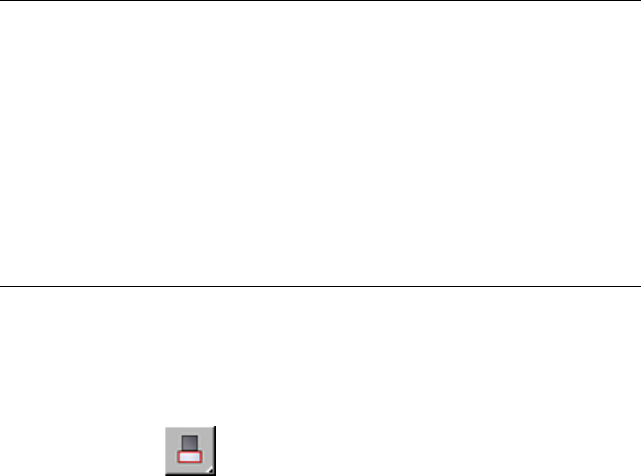
You can restrict the objects' scaling about the X, Y, or Z axis, or to any two
axes, by first clicking the appropriate button on the Axis Constraints toolbar
on page 7288 , or with the Transform gizmo on page 865 .
To scale a single object, you don't need to select it first. When this tool is
active, clicking an object selects it and dragging the mouse scales it.
IMPORTANT Avoid applying non-uniform scale at the object level. Non-uniform
scaling is applied as a transform and changes the axes of the object, so it affects
other object properties. It also alters the properties passed hierarchically from
parent to child. When you perform other operations on the object, such as rotation,
inverse kinematic calculations, and other positioning operations, you might not
get the results you expect. To recover from these problems, use the Hierarchy
panel's Reset Scale button or the Utilities panel's Reset XForm utility. Either of these
options will reset the axes to use the non-uniform scale as the fundamental scale
for the object.
As an alternative to non-uniform scaling, consider using the XForm modifier
on page 1922 .
See also:
■Scale Gizmo on page 870
Select and Squash
Main toolbar > Select And Squash (on Select And Scale flyout)
Right-click an object. > Scale (selects current toolbar Scale mode)
The Select And Squash tool is useful for creating different phases of the “squash
and stretch”-style animation often found in cartoons. The Select And Squash
tool, available from the Select And Scale flyout on page 891 , lets you scale
objects according to the active axis constraint. Squashing an object always
involves scaling down on one axis while simultaneously scaling up uniformly
on the other two (or vice-versa).
894 | Chapter 7 Moving, Rotating, and Scaling Objects
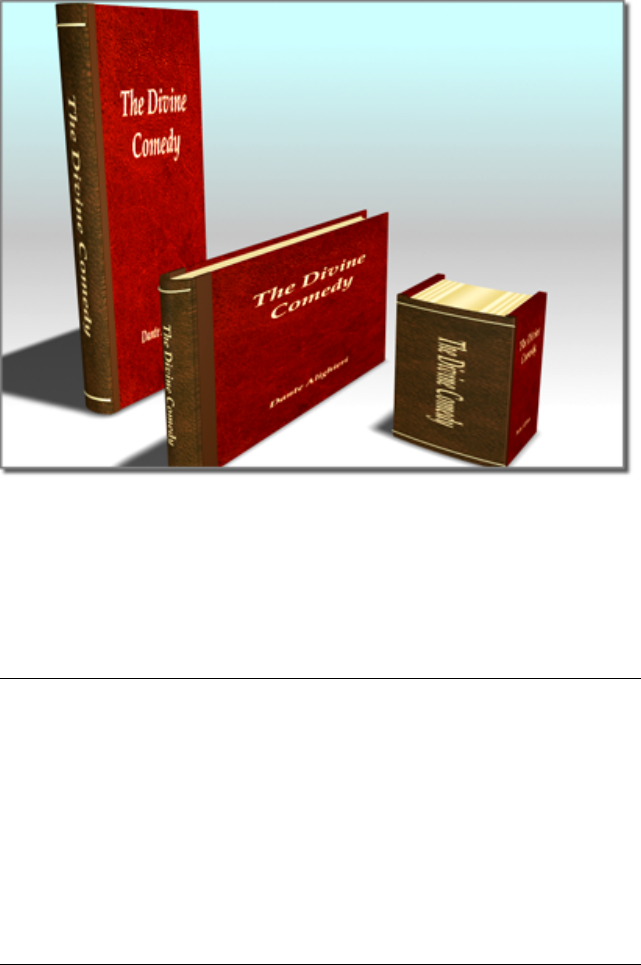
Squash scales two axes in opposite directions, maintaining the object's original volume.
You can restrict object scaling to the X, Y, or Z axis, or to any two axes, by
first clicking the appropriate button on the Axis Constraints toolbar on page
7288 .
When the Select And Squash tool is active, clicking an object selects it and
dragging the mouse scales it.
IMPORTANT Avoid using Select And Squash at the object level. The non-uniform
scaling that it effects is applied as a transform and changes the axes of the object,
so it affects other object properties. It also alters the properties passed hierarchically
from parent to child. When you perform other operations on the object, such as
rotation, inverse kinematics calculations, and other positioning operations, you
may not get the results you expect. To recover from these problems, use the
Hierarchy panel's Reset Scale button or the Utilities panel's Reset XForm utility.
Either of these options will reset the axes to use the non-uniform scale as the
fundamental scale for the object.
As an alternative to non-uniform scaling with Select And Squash, consider
using the XForm modifier on page 1922 .
Select and Squash | 895

See also:
■Scale Gizmo on page 870
Transform Coordinates and Coordinate
Center
Controls for setting the coordinate system and the active center for transforms
to use are on the default main toolbar on page 7284 .
Reference Coordinate System on page 896
Use Pivot Point Center on page 905
Use Selection Center on page 907
Use Transform Coordinate Center on page 908
See also:
■Moving, Rotating, and Scaling Objects on page 859
Reference Coordinate System
Main toolbar > Reference Coordinate System list
896 | Chapter 7 Moving, Rotating, and Scaling Objects
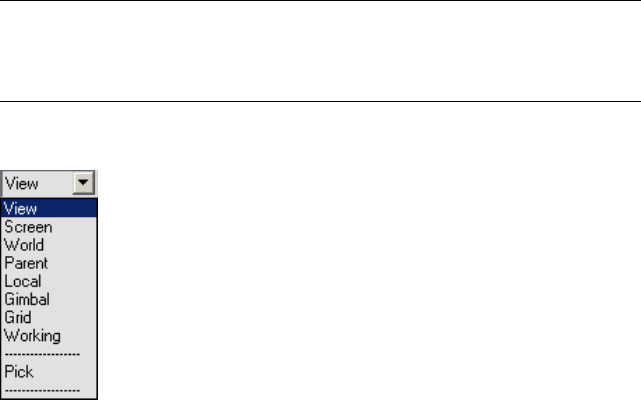
The Reference Coordinate System list lets you specify the coordinate system
used for a transformation (Move, Rotate, and Scale). Options include View,
Screen, World on page 7975 , Parent, Local on page 7830 , Gimbal, Grid, Working
on page 3402 , and Pick.
In the Screen coordinate system, all views (including perspective views) use
the viewport screen coordinates.
View is a hybrid of World and Screen coordinate systems. Using View, all
orthographic views use the Screen coordinate system, while perspective views
use the World coordinate system.
TIP The coordinate system is set on a transform-by-transform basis, so choose the
transform before you specify the coordinate system. If you do not want the
coordinate system to change, turn on Customize menu > Preferences > General
panel > Ref. Coord. System group > Constant.
Interface
View In the default View coordinate system, X, Y, and Z axes are the same
in all orthogonal viewports. When you move an object using this coordinate
system, you are moving it relative to the space of the viewport.
■X always points right.
■Y always points up.
■Z always points straight out of the screen toward you.
Reference Coordinate System | 897
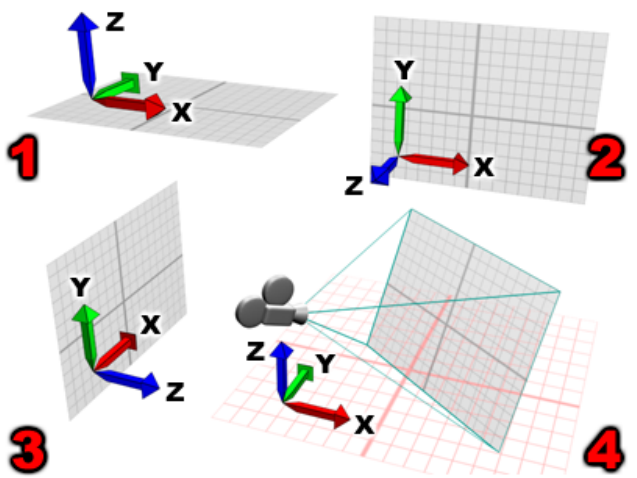
Different orientations of the View coordinate system:
1. Top viewport.
2. Front viewport.
3. Left viewport.
4. Perspective viewport.
Screen Uses the active viewport screen as the coordinate system.
■X is horizontal, running in a positive direction toward the right.
■Y is vertical, running in a positive direction upward.
■Z is depth, running in a positive direction toward you.
Since the Screen mode depends on the active viewport for its orientation,
the X, Y, and Z labels on an axis tripod on page 860 in an inactive viewport
show the orientation of the currently active viewport. The labels on that
tripod change when you activate the viewport it is in.
898 | Chapter 7 Moving, Rotating, and Scaling Objects
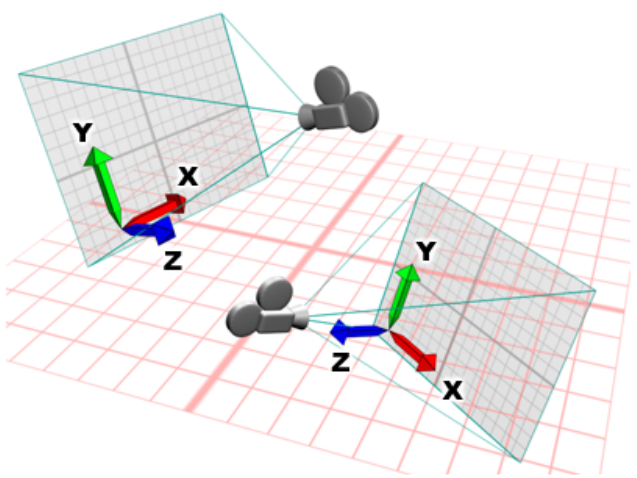
The coordinate system in Screen mode is always relative to the point of view.
World Uses the world coordinate system. Seen from the front:
■X runs in a positive direction to the right.
■Z runs in a positive direction upward.
■Y runs in a positive direction away from you.
Reference Coordinate System | 899
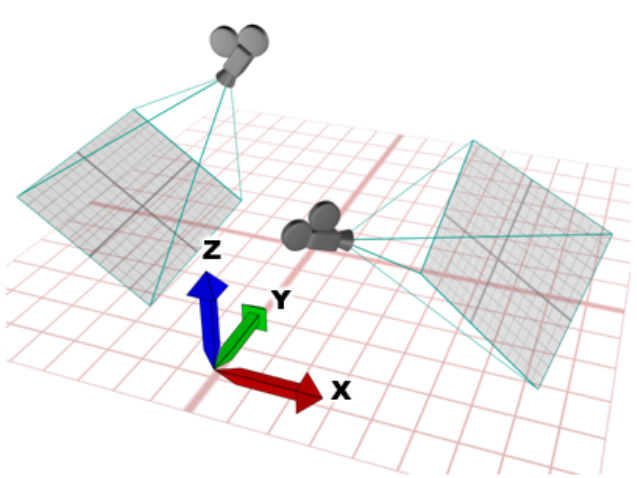
The World coordinate system is always fixed.
Parent Uses the coordinate system of the parent of the selected object. If
the object is not linked to a specific object, it's a child of the world, and the
parent coordinate system is the same as the world coordinate system.
900 | Chapter 7 Moving, Rotating, and Scaling Objects
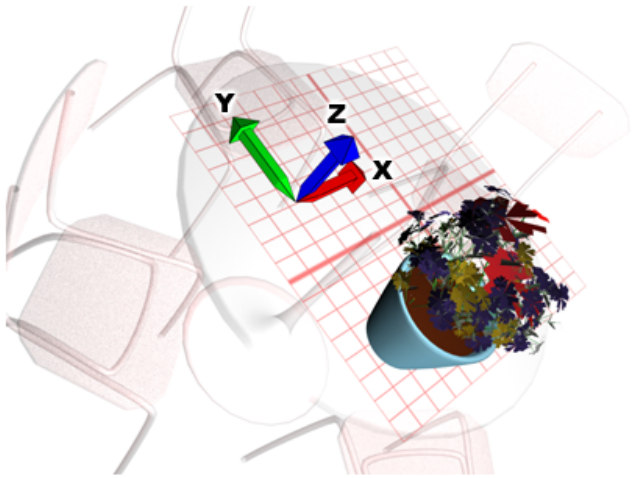
Example of a Parent object coordinate system
Local Uses the coordinate system of the selected object. An object's local
coordinate system is carried by its pivot point on page 7895 . You can adjust
the position and orientation of the local coordinate system, relative to its
object, using the options on the Hierarchy command panel.
When Local is active, the Use Transform Center button is inactive and all
transforms use the local axis as the center of transformation. In a selection
set of several objects, each uses its own center for the transform.
Reference Coordinate System | 901
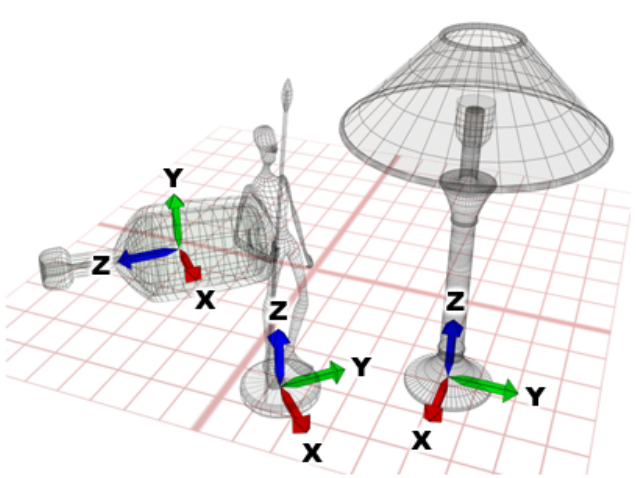
Local uses an individual coordinate system specific to each object.
Gimbal The Gimbal coordinate system is meant to be used with the Euler
XYZ Rotation controller on page 3076 . It is similar to Local, but its three rotation
axes are not necessarily orthogonal to each other.
When you rotate about a single axis with the Local and Parent coordinate
systems, this can change two or three of the Euler XYZ tracks. The Gimbal
coordinate system avoids this problem: Euler XYZ rotation about one axis
changes only that axis's track. This makes function curve editing easier. Also,
absolute transform type-in with Gimbal coordinates uses the same Euler angle
values as the animation tracks (as opposed to Euler angles relative to the World
or Parent coordinate system, as those coordinate systems require).
For move and scale transforms, Gimbal coordinates are the same as Parent
coordinates. When the object does not have an Euler XYZ Rotation controller
assigned, Gimbal rotation is the same as Parent rotation.
The Euler XYZ controller can be the active controller in a List controller, too.
Grid Uses the coordinate system of the active grid.
902 | Chapter 7 Moving, Rotating, and Scaling Objects
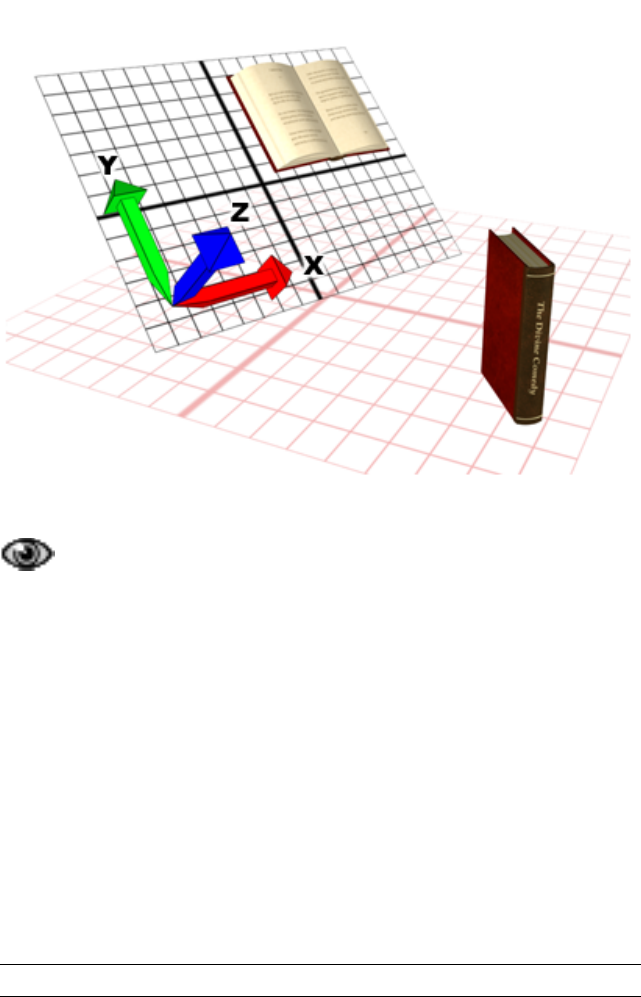
Using an active grid coordinate system.
Working Uses the coordinate system of the working pivot on page
3402 . You can use this coordinate system at any time, whether or not the
working pivot is active. When Use Working Pivot on page 3405 is on, this is
the default coordinate system.
Pick Uses the coordinate system of another object in the scene.
After you choose Pick, click to select the single object whose coordinate system
the transforms will use. The object's name appears in the Transform Coordinate
System list.
Because the software saves an object's name in the list, you can pick an object's
coordinate system, change the active coordinate system, and then use the
object's coordinate system again at a later time. The list saves the four most
recently picked object names.
When using Pick to specify an object as a reference coordinate system, you
can press H to open the Pick Object dialog, which works like Select From
Scene on page 168 , and pick the object from there.
NOTE You can pick objects within an XRef scene as coordinate reference system.
Reference Coordinate System | 903
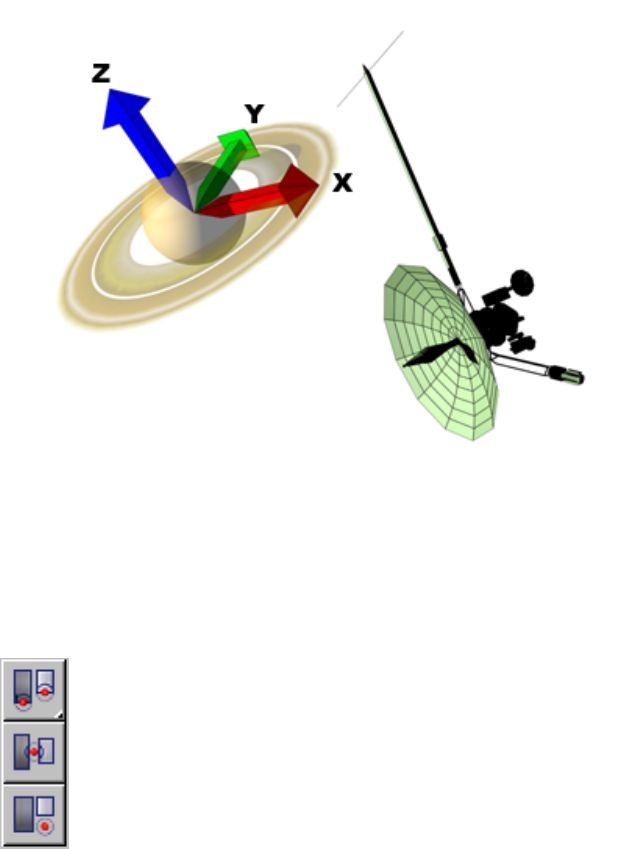
Using another object as the coordinate system
Use Center Flyout
Main toolbar > Use Center flyout
The Use Center flyout provides access to three methods you can use to
determine the geometric center for scale and rotate operations. They are, from
top to bottom:
Use Pivot Point Center on page 905
Use Selection Center on page 907
904 | Chapter 7 Moving, Rotating, and Scaling Objects
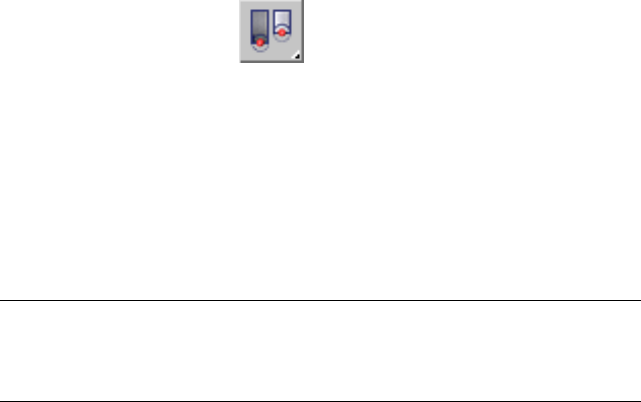
Use Transform Coordinate Center on page 908
See also:
■Choosing a Transform Center on page 882
Use Pivot Point Center
Main toolbar > Use Pivot Point Center (on Use Center flyout)
The Use Pivot Point Center option, available from the Use Center flyout on
page 904 , lets you enable rotation or scaling of one or more objects around
their respective pivot points on page 7895 . When Auto Key on page 7344 is
active, Use Pivot Point Center is automatically chosen and no other option is
available.
The axis tripods on page 860 show the centers that are currently being used.
NOTE The transformation center mode is set on a transform-by-transform basis,
so select the transform before you select the center mode. If you do not want the
center setting to change, turn on Customize menu > Preferences > General tab >
Reference Coordinate System group > Constant.
Use Pivot Point Center | 905
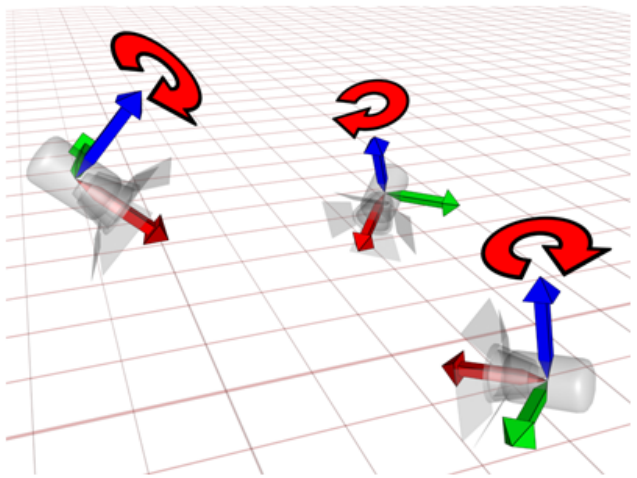
Applying a rotation with the Pivot Point rotates each object around its own local axis.
Rotating Multiple Linked Objects
When rotating a chain of linked on page 3267 objects (that is, a hierarchy)
with Use Pivot Point Center active, the rotation is applied equally to each
906 | Chapter 7 Moving, Rotating, and Scaling Objects
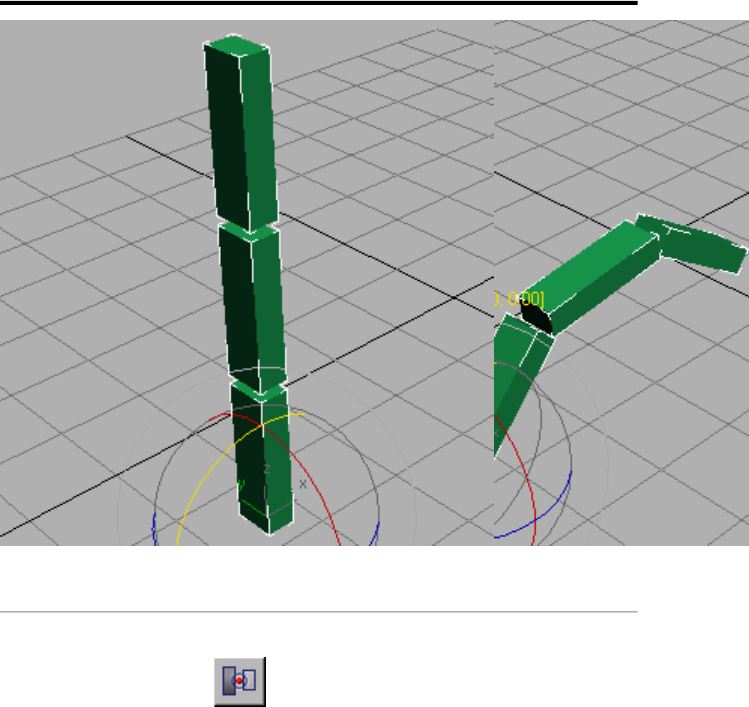
object in the chain. This results in a accumulated rotations, which makes it
easy to animate such effects as fingers curling.
Use Selection Center
Main toolbar > Use Selection Center (on Use Center flyout)
The Use Selection Center button, available from the Use Center flyout on
page 904 , lets you enable rotation or scaling of one or more objects around
their collective geometric center. If you transform multiple objects, the software
calculates the average geometric center of all the objects and uses that for the
transform center.
The axis tripod on page 860 shows the center that is currently being used.
Use Selection Center | 907
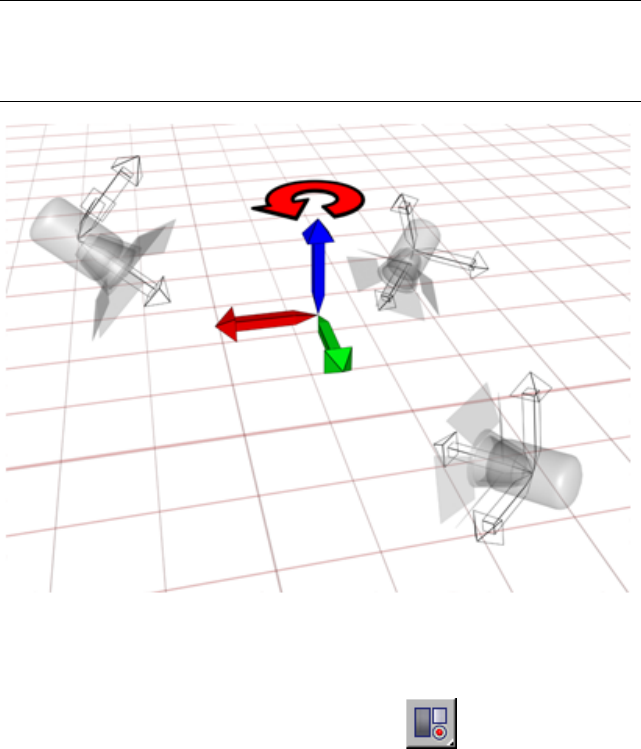
NOTE The transformation center mode is set on a transform-by-transform basis,
so select the transform before you select the center mode. If you do not want the
center setting to change, turn on Customize menu > Preferences > General tab >
Reference Coordinate System group > Constant.
With the Selection Center option, an averaged coordinate system is used to rotate the
objects.
Use Transform Coordinate Center
Main toolbar > Use Transform Coordinate Center (on Use Center flyout)
The Use Transform Coordinate Center button, available from the Use Center
flyout on page 904 , lets you enable rotation or scaling of an object or objects
around the center of the current coordinate system. When you designate
another object as the coordinate system with the Pick function (see Specifying
a Reference Coordinate System on page 881 ), the coordinate center is the
location of that object's pivot.
The axis tripod on page 860 shows the center that is currently being used.
908 | Chapter 7 Moving, Rotating, and Scaling Objects
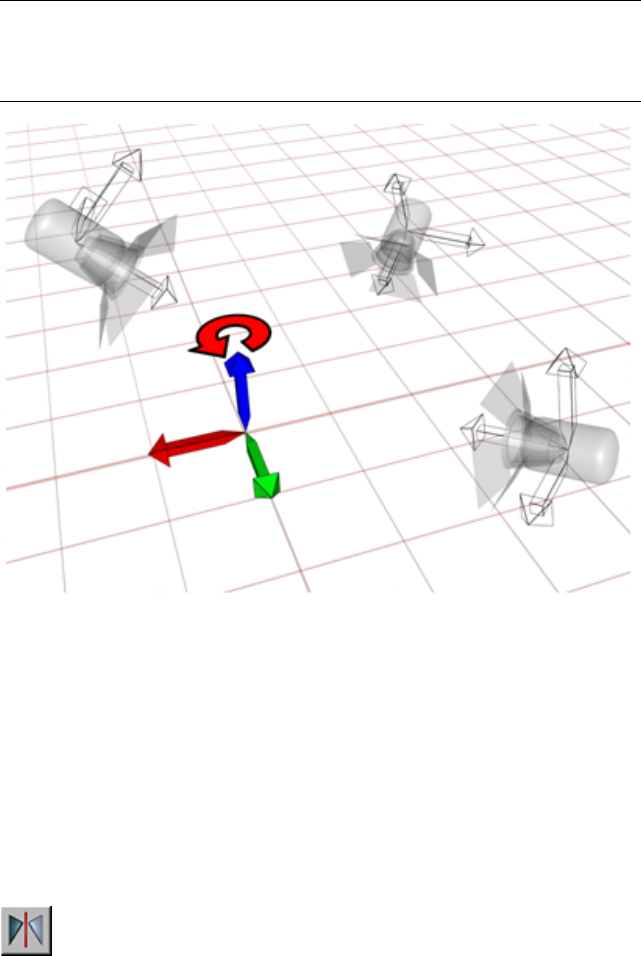
NOTE The transformation center mode is set on a transform-by-transform basis,
so select the transform before you select the center mode. If you do not want the
center setting to change, turn on Customize menu > Preferences > General tab >
Reference Coordinate System group > Constant.
An example of the World coordinate center
Transform Tools
The transform tools can transform objects according to certain conditions.
Some of them, such as Array, can also create copies of objects.
These tools (except for Array, Snapshot, Spacing Tool, and Clone And Align)
are available on the default main toolbar on page 7284 ; the remainder are on
the Extras toolbar on page 7290 . Also, they all appear on the default Tools
menu on page 7260 .
Mirror Selected Objects on page 911
Transform Tools | 909

Array on page 915
Snapshot on page 921
Spacing Tool on page 925
Clone and Align Tool on page 933
Align on page 938
Quick Align on page 944
Normal Align on page 945
Place Highlight on page 948
Align Camera on page 950
Align to View on page 951
See also:
■Moving, Rotating, and Scaling Objects on page 859
■Using +Clone on page 968
■Creating Copies and Arrays on page 953
910 | Chapter 7 Moving, Rotating, and Scaling Objects
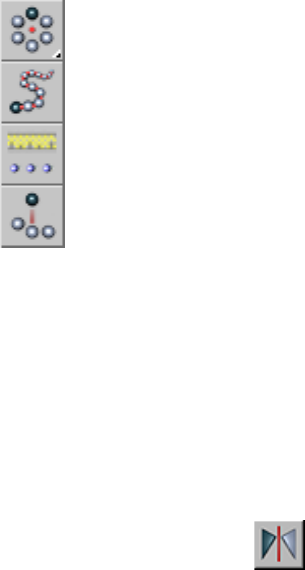
Array Flyout
Extras toolbar > Array flyout
The Array flyout, available from the Extras toolbar on page 7290 , provides
access to various tools for creating arrays of objects. These are, from top to
bottom:
Array on page 915
Snapshot on page 921
Spacing Tool on page 925
Clone and Align Tool on page 933
Mirror Selected Objects
Main toolbar > Mirror Selected Objects
Tools menu > Mirror
Clicking Mirror displays the Mirror dialog, which enables you to move one
or more objects while mirroring their orientation. The Mirror dialog also allows
you to mirror the current selection about the center of the current coordinate
system. You can create a clone with the mirror dialog at the same time. If you
mirror a hierarchical linkage, you have the option to mirror the IK limits.
Array Flyout | 911

Mirroring an object
The Mirror dialog uses the current reference coordinate system on page 896 ,
as reflected in its name. For example, if Reference Coordinate System is set to
Local, the dialog is named Mirror: Local Coordinates. There is one exception:
If Reference Coordinate System is set to View, Mirror uses Screen coordinates.
As you adjust the various settings in the Mirror dialog, you see the results in
the viewports.
For more information on using Mirror, see Mirroring Objects on page 996 .
Procedures
To mirror an object:
1Make any object selection.
2 Click Mirror on the Main toolbar, or choose Tools menu > Mirror.
The Mirror dialog opens.
3Set the mirror parameters in the dialog and click OK.
912 | Chapter 7 Moving, Rotating, and Scaling Objects

The active viewport changes to show the effect of each parameter as you
set it. When you click OK, the software creates the choice of mirror that
you see previewed.
To make a clone using mirror:
1Make any object selection
2 Click Mirror on the Main toolbar, or choose Tools menu > Mirror.
The Mirror dialog opens.
3In the Clone Selection group, choose Copy, Instance, or Reference.
4Make any additional settings as desired and then click OK.
Mirror Selected Objects | 913
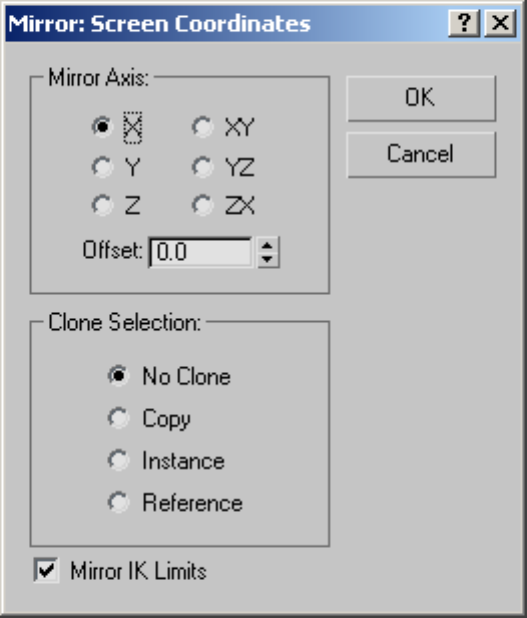
Interface
Mirror Axis group
The mirror axis choices are X, Y, Z, XY, XZ, and YZ. Choose one to specify
the direction of mirroring. These are equivalent to the option buttons on the
Axis Constraints toolbar on page 7288 .
Offset Specifies the distance of the mirrored object's pivot point on page
7895 from the original object's pivot point.
Clone Selection group
Determines the type of copy made by the Mirror function. Default is No Clone.
No Clone Mirrors the selected object without making a copy.
914 | Chapter 7 Moving, Rotating, and Scaling Objects

Copy Mirrors a copy of the selected object to the specified position.
Instance Mirrors an instance on page 7818 of the selected object to the
specified position.
Reference Mirrors a reference on page 7910 of the selected object to the
specified position.
If you animate on page 3002 the mirror operation, mirroring generates a Scale
key. If you set Offset to a value other than 0.0, mirroring also generates Position
keys.
Mirror IK Limits Causes the IK constraints to be mirrored (along with the
geometry) when you mirror the geometry about a single axis. Turn this off if
you don't want the IK constraints to be affected by the mirror command.
The end effectors used by the IK are not affected by the Mirror command. To
successfully mirror an IK hierarchy, first delete the end effectors: Go to the
Motion panel > IK Controller Parameters rollout > End Effectors group and,
under Position, click the Delete button. After the mirror operation, create the
new end effector using the tools on the same panel.
Array
Extras toolbar > Array
Tools menu > Array
The Array command displays the Array dialog, which enables you to create
an array of objects based on the current selection.
Array | 915
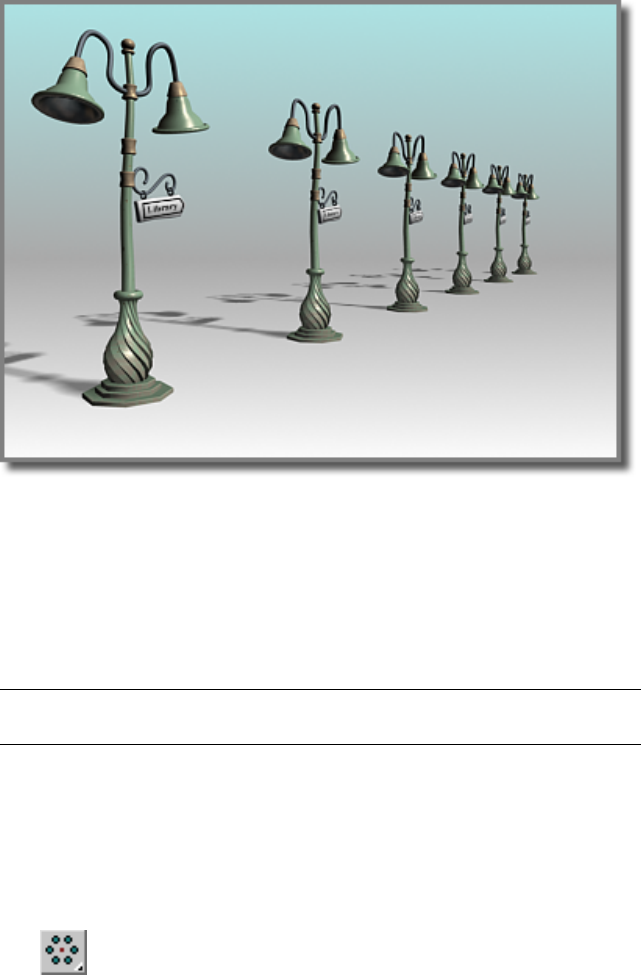
A one-dimensional array
The items in the Array Dimensions group let you create one-, two-, and
three-dimensional arrays. For example, a row of five objects is a
single-dimension array, even though it takes up three-dimensional space in
the scene. An array of objects that's five rows by three columns is a
two-dimensional array, and an array of objects that's five rows by three
columns by two levels is a three-dimensional array.
TIP You can preview the array by turning on the Preview button. With Preview
on, changing the array settings updates the viewports in real time.
For more information on using Array, see Arraying Objects on page 981 .
Procedures
To create an array:
1Select the objects to array.
2 Click the Array button, or choose Tools > Array.
916 | Chapter 7 Moving, Rotating, and Scaling Objects

3Choose Tools > Array.
4On the Array dialog, select the type of object to output: Copy, Instance,
on page 7818 or Reference on page 7910 ).
5In the Preview group, click the Preview button to turn it on.
This lets you see the results of the array operation in the viewports, with
changes appearing in real time.
6In the Array Transformation group, click the arrows to set Incremental
or Totals array parameters for Move, Rotate, and Scale.
7Enter coordinates for the Array Transformation parameters.
8Indicate whether you want a 1D, 2D, or 3D array.
9Set Count to the number of copies on each axis.
10 Enter the appropriate values in the numeric fields for Incremental Row
Offsets.
11 Click OK.
The current selection is duplicated the specified number of times, with
each object transformed as indicated.
To replace an array:
1Undo the array to replace, using Edit > Undo Create Array, or press Ctrl+Z.
2Change the coordinate system and transform center, if needed.
3 Click the Array button, or choose Tools > Array, and adjust any
parameters on the Array dialog that is displayed.
4Choose Tools > Array, and adjust any parameters on the Array dialog that
is displayed.
5Click OK to create a new array, which replaces the previous version.
Repeat these steps to fine-tune the array.
Example: To create an array of objects that numbers 5 x 4 x 3:
1Create a teapot with a radius of 10 units.
2Choose Tools > Array to display the Array dialog.
Array | 917
3In the Incremental set of parameters, set Move X (the upper-left field) to
50. This causes each object in the array to be positioned 50 units apart
on the X axis.
4In the Array Dimensions group, choose the 3D button to enable all the
spinners in that group.
5Set the 1D Count spinner to 5, the 2D Count spinner to 4, and the 3D
Count spinner to 3.
This creates a row of 5 objects that are 50 units apart, and then 4 rows
of those five objects, and then 3 rows of the 5 x 4 matrix of objects,
resulting in a box array.
6In the 2D row, set the Y spinner to 80.
7In the 3D row, set the Z spinner to 100.
8Click OK.
A box array of teapots appears. The first dimensional array is five teapots
created along the X world axis, 50 units apart (as specified in the Array
Transform group). The second dimensional array is four layers created
along the Y world axis, 80 units apart (as specified in the Array
Dimensions group). The third dimensional array is three layers created
along the Z world axis, 100 units apart. The total number of objects in
the array is 60.
Example: To create a 360-degree array:
1Reset 3ds Max.
2Near the top of the Front viewport (away from its center), create a long,
thin box at the twelve-o'clock position (as if the viewport were a clock
face).
3Choose Use Transform Coordinate Center on the Main toolbar.
4Choose Tools > Array.
5Click the arrow button to the right of the Rotate label to enable the three
Rotate fields in the Totals section.
6Set the Z parameter to 360.0.
7In the Array Dimensions group, choose 1D and set Count to 12.
8Click OK.
The software creates an array of 12 boxes in a full circle.
918 | Chapter 7 Moving, Rotating, and Scaling Objects
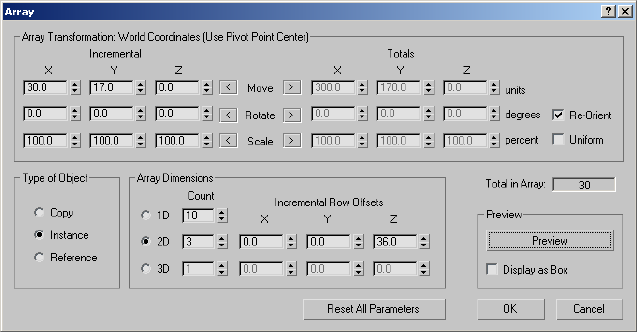
Interface
Array Transformation group
Specifies which combination of the three transforms to use to create the array.
You also specify the extent, along the three axes, for each transform. You can
specify the extent of the transform in increments between each object, or in
totals for all objects. In either case, the distances are measured between the
pivot points of the objects. The arrays occur using the current transform
settings, so the group title changes depending on the transform settings.
Click the left or right arrow button for Move, Rotate, or Scale to indicate
whether you want to set Incremental or Total array parameters.
Incremental
Move Specifies the distance between each arrayed object along the X, Y, and
Z axes, in units.
Rotate Specifies the degree of rotation about any of the three axes for each
object in the array, in degrees.
Scale Specifies the percentage of scale along any of the three axes for each
object in the array, in percentages.
Totals
Move Specifies the overall distance, along each of the three axes, between
the pivot points of the two outer objects in the resulting array. For example,
Array | 919
if you're arraying 6 objects and set Move X total to 100, the six objects will
be arrayed in a row that's 100 units between the pivot points of the two outer
objects in the row.
Rotate Specifies the total degrees of rotation applied to the objects along
each of the three axes. You can use this, for example, to create an array that
totals 360 degrees.
Re-Orient Rotates the generated objects about their local axes while rotating
them about the world coordinates. When clear, the objects maintain their
original orientation.
Scale Specifies the total scale of the objects along each of the three axes.
Uniform Disables the Y and Z spinners and applies the X value to all axes,
resulting in a uniform scale.
Type of Object group
Determine the type of copies made by the Array function. The default is Copy.
Copy Arrays copies of the selected object to the specified position.
Instance Arrays instances of the selected object to the specified position.
Reference Arrays references of the selected object to the specified position.
Array Dimensions group
Lets you add to the Array Transformation dimension. The additional
dimensions are positional only. Rotation and scale are not used.
1D Creates a one-dimensional array, based on the settings in the Array
Transformation group.
Count Specifies the total number of objects along this dimension of the
array. For 1D arrays, this is the total number of objects in the array.
2D Creates a two-dimensional array.
Count Specifies the total number of objects along this second dimension of
the array.
X/Y/Z Specifies the incremental offset distance along each axis of the second
dimension of the array.
3D Creates a three-dimensional array.
Count Specifies the total number of objects along this third dimension of
the array.
920 | Chapter 7 Moving, Rotating, and Scaling Objects

X/Y/Z Specifies the incremental offset distance along each axis of the third
dimension of the array.
Total in Array Displays the total number of entities that the array operation
will create, including the current selection. If you're arraying a selection set,
the total number of objects will be the result of multiplying this value times
the number of objects in the selection set.
Preview Toggles a viewport preview of the current array settings. Changing
a setting updates the viewports immediately. If the update slows down feedback
with large arrays of complex objects, turn on Display As Box.
Display as Box Displays the array-preview objects as bounding boxes instead
of geometry.
Reset All Parameters Resets all the parameters to their default settings.
Snapshot
Extras toolbar > Snapshot (on Array flyout)
Tools menu > Snapshot
Choosing Tools > Snapshot displays the Snapshot dialog. This enables you to
clone an animated object over time.
Snapshot | 921
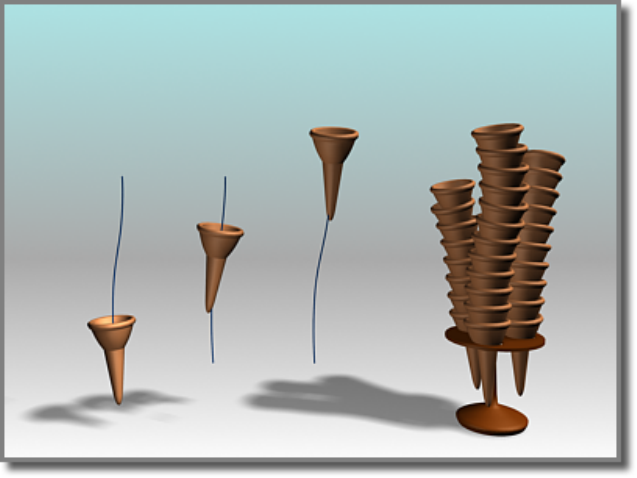
Using an ice-cream cone animated along a path, Snapshot creates a stack of cones.
Snapshot spaces the clones equally in time. Adjustments in Track View let
you space the clones equally along the path instead (see the second procedure,
below).
Like other clone techniques, Snapshot creates copies, instances, or references.
You can also choose a mesh option for use with particle systems.
Particle Snapshots
You can clone particle systems as static mesh objects. You can also produce
clones of the particles themselves as meshes, when using the Snapshot dialog
> Clone Method > Mesh option. This works with all configurations of particle
systems, including those using MetaParticles. Usage is the same as with other
types of objects.
Procedures
To clone an object over time:
1Select an object with an animation path.
922 | Chapter 7 Moving, Rotating, and Scaling Objects

Snapshot also shows the effect of any other transform animations, such
as rotate or scale as well as parametric modifier animation.
2 Click the Snapshot button on the Extras toolbar > Array flyout, or
choose Tools menu > Snapshot.
3Set parameters in the dialog, and click OK.
To space clones evenly by distance:
1Select an object with an animated position.
2Open Track View and find the Position track for the original object.
3Click Assign Controller and check that the track is using a Bezier Position
controller. Do one of the following:
■If the track is already using a Bezier Position controller, proceed to
step 4.
■If the track is not using a Bezier Position controller, change the
controller on page 3515 , then proceed to step 4.
4Select all the transform keys and right-click one of the selected keys to
display the Key Info dialog on page 3052 .
5Click Advanced to expand the dialog.
6Click Normalize Time.
7Set Constant Velocity on.
8Choose Tools menu > Snapshot.
The Snapshot dialog appears.
9Set parameters in the dialog, and click OK.
Snapshot | 923
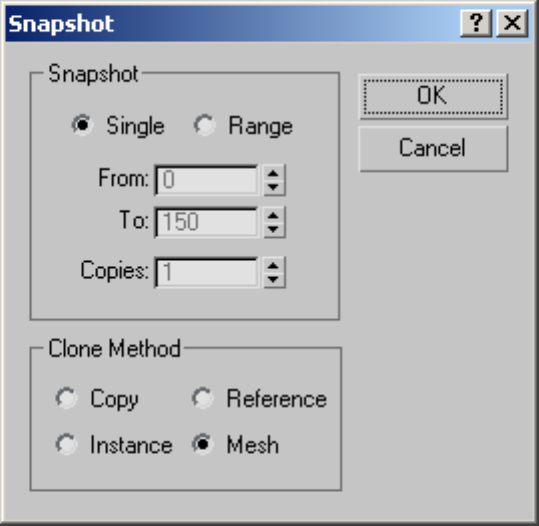
Interface
Snapshot group
Single Makes a clone of the geometry of the object at the current frame.
Range Makes clones of the geometry of the object along the trajectory over
a range of frames. Specify the range with the From/To settings and the number
of clones with the Copies setting.
From/To Specifies the range of frames to place the cloned object along the
trajectory.
Copies Specifies the number of clones to place along the trajectory. They
are evenly distributed over the time period, but not necessarily over the spatial
distance along the path.
924 | Chapter 7 Moving, Rotating, and Scaling Objects

Clone Method group
With the Copy, Instance, and Reference methods, the clone retains any
animation within the object, so all the clones will be animated in the same
way.
Copy Clones copies of the selected object.
Instance Clones instances on page 7818 of the selected object. Not available
with particle systems.
Reference Clones references on page 7910 of the selected object. Not available
with particle systems.
Mesh Use this to create mesh geometry out of particle system. Works with
all kinds of particles.
Spacing Tool
Extras toolbar > Spacing Tool (on Array flyout)
Tools menu > Spacing Tool
The Spacing tool lets you distribute objects based on the current selection
along a path defined by a spline or a pair of points.
The distributed objects can be copies, instances on page 7818 , or references
on page 7910 of the current selected object. You define a path by picking a
spline or two points and by setting a number of parameters. You can also
specify how the spacing between objects is determined and whether the pivot
points of the objects align to the tangent of the spline.
Spacing Tool | 925
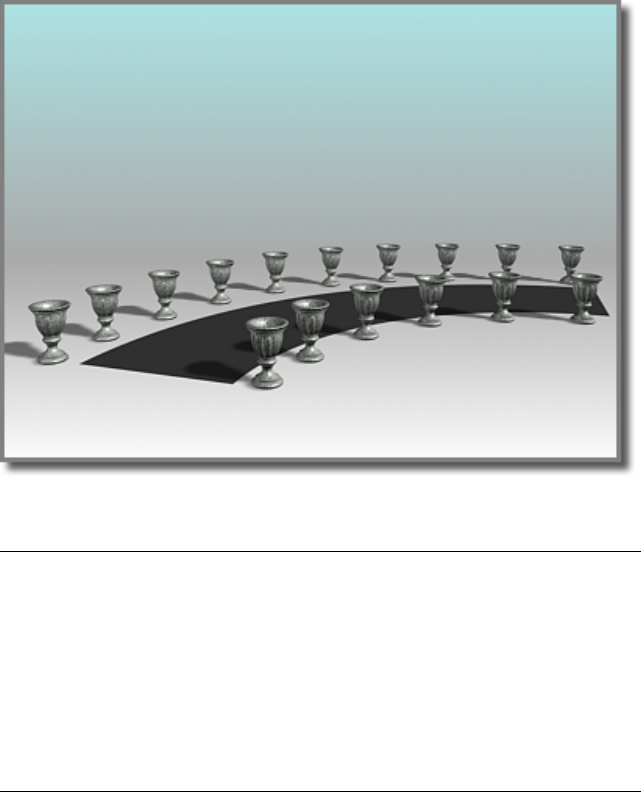
The Spacing tool distributes the vases along the sides of the curved street. The vases
are all the same distance from each other; fewer appear on the shorter side.
TIP You can use compound shapes containing multiple splines as the spline path
for distributing objects. Before creating shapes, turn off Start New Shape on the
Create panel. Then create your shapes. The software adds each spline to the current
shape until you click the Start New Shape button so that it's turned on. When you
select the compound shape so that the Spacing tool can use it as a path, objects
are distributed along all of the splines of the compound shape. For example, you
might find this technique useful in spacing light standards along a path defined
by separated splines.
You can pick splines within an XRef scene as path reference.
For more information, see Using the Spacing Tool on page 998 .
Procedures
To distribute objects along a path:
1Select the objects to distribute.
926 | Chapter 7 Moving, Rotating, and Scaling Objects

2 Click Spacing Tool, or choose Tools menu > Spacing Tool.
NOTE The Spacing tool is also available on rollouts for various components
of the Railing object on page 447 .
3On the Spacing Tool dialog, click Pick Path or Pick Points to specify a
path.
If you click Pick Path, select a spline from your scene to use as the path.
If you click Pick Points, pick a start and an end to define a spline as the
path. When you're finished with the Spacing tool, the software deletes
this spline.
4Choose a spacing option from the Parameters list.
The parameters available for Count, Spacing, Start Offset, and End Offset
are dependent on the spacing option you choose.
5Specify the number of objects to distribute by setting the value of Count.
6Depending on the spacing option you choose, adjust the spacing and
offsets.
7Under Context, choose Edge to specify that spacing be determined from
the facing edges of each object's bounding box, or choose Centers to
specify that spacing be determined from the center of each object's
bounding box.
8Turn on Follow if you want to align the pivot points of the distributed
objects to the tangent of the spline.
9Under Type of Object, select the type of object to output (copy, instance
on page 7818 , or reference on page 7910 ).
10 Click Apply.
Spacing Tool | 927
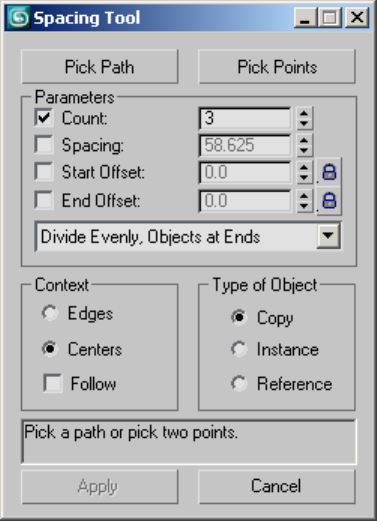
Interface
The Spacing tool gives you a choice of two basic methods for setting spacing:
using a path, or specifying endpoints explicitly.
Pick Path Click this, and then click a spline in the viewport to use as the
path. The software uses the spline as the path along which to distribute objects.
Pick Points Click this, and then click a start and an end to define a path on
the construction grid. You can also use object snap to specify points in space.
The software uses these points to create a spline as the path along which to
distribute objects. When you're finished with the Spacing tool, the software
deletes the spline.
Parameters group
Count The number of objects to distribute.
Spacing Specifies the space in units between the objects. The software
determines this spacing based on whether you chose Edges on page 932 or
Centers on page 932 .
928 | Chapter 7 Moving, Rotating, and Scaling Objects
Start Offset The number of units specifying an offset from the start of the
path. Clicking the lock icon locks the start offset value to the spacing value
and maintains the count.
End Offset The number of units specifying an offset from the end of the
path. Clicking the lock icon locks the end offset value to the spacing value
and maintains the count.
Distribution drop-down list This list contains a number of options for how
to distribute the objects along the path, as follows:
■Free Center Distributes equally spaced objects along a straight line toward
the end point of the path, beginning at the start of the path. A spline or
a pair of points defines the path. You specify the number of objects and
the spacing.
■Divide Evenly, Objects at Ends Distributes objects along a spline. The
group of objects is centered at the middle of the spline. The Spacing tool
evenly fills the spline with the number of objects you specify and
determines the amount of space between objects. When you specify more
than one object, there are always objects at the ends of the spline.
■Centered, Specify Spacing Distributes objects along a path. The group
of objects is centered at the middle of the path. The Spacing tool attempts
to evenly fill the path with as many objects as it can fit along the length
of the path using the amount of space you specify. Whether there are
objects at the ends of the path depends on the length of the path and the
spacing you provide.
■End Offset Distributes the number of objects you specify along a straight
line. The objects begin at an offset distance that you specify. This distance
is from the end of the spline to its start point, or from the second pair of
points to the first point. You also specify the spacing between objects.
■End Offset, Divide Evenly Distributes the number of objects you specify
between the start of a spline or a pair of points and an end offset that you
specify. The software always places an object at the end or its offset. When
you specify more than one object, there is always an object placed at the
start. The Spacing tool attempts to evenly fill the space with the objects
between the end offset and the start.
■End Offset, Specify Spacing Distributes objects toward the start of a spline
or a pair of points, starting at the end or its offset. The software always
places an object at the end or its offset. You specify the spacing between
objects and the offset from the end. The Spacing tool attempts to evenly
Spacing Tool | 929
fill the space with as many objects as it can fit between the end or its offset
and the start. There might not always be an object placed at the start.
■Start Offset Distributes the number of objects you specify along a straight
line. The objects start at an offset distance that you specify. This distance
is from the start of the spline to its end point, or from the first of a pair of
points to the second. You also specify the spacing between objects.
■Start Offset, Divide Evenly Distributes the number of objects you specify
between the end of a spline or a pair of points, starting at an offset that
you specify from the start. The software always places an object at the start
or its offset. When you specify more than one object, there is always an
object placed at the end. The Spacing tool attempts to evenly fill the space
with the objects between the start or its offset and the end.
■Start Offset, Specify Spacing Distributes objects toward the end of a
spline or a pair of points, starting at the start. The software always places
an object at the start or its offset. You specify the spacing between objects
and the offset from the start. The Spacing tool attempts to evenly fill the
space with as many objects as it can fit between the start or its offset and
the end. There might not always be an object placed at the end.
■Specify Offsets and Spacing Distributes as many equally spaced objects
as possible along a spline or between a pair of points. You specify the
spacing between objects. When you specify offsets from the start and end,
the software distributes equally spaced objects between the offsets. There
might not always be an object placed at the start and ends.
■Specify Offsets, Divide Evenly Distributes the number of objects you
specify along a spline or between a pair of points. If you specify one object
the software places it at the center of the path. If you specify more than
one object the software always places an object at the start offset and the
end offset. If you specify more than two objects the software evenly
distributes the objects between the offsets.
■Space from End, Unbounded Distributes the number of objects you
specify along a straight line from the end toward the start of a spline or a
pair of points. You specify the spacing between objects. The software locks
the end offset so that it's the same as the spacing.
■Space from End, Specify Number Distributes the number of objects you
specify toward the start of a spline or a pair of points, starting at the end.
The Spacing tool determines the amount of space between objects based
on the number of objects and the length of the spline or the distance
between the pair of points. The software locks the end offset so that it's
the same as the spacing.
930 | Chapter 7 Moving, Rotating, and Scaling Objects
■Space from End, Specify Spacing Distributes as many equally spaced
objects as possible toward the start of a spline or a pair of points, starting
at the end. You specify the spacing between objects. The software locks
the end offset so that it's the same as the spacing.
■Space from Start, Unbounded Distributes the number of objects you
specify along a straight line toward the end of a spline or a pair of points,
starting at the start. You specify the spacing between objects. The software
locks the start offset so that it's the same as the spacing.
■Space from Start, Specify Number Distributes the number of objects you
specify toward the end of a spline or a pair of points, starting at the start.
The Spacing tool determines the amount of space between objects based
on the number of objects and the length of the spline or the distance
between the pair of points. The software locks the start offset so that it's
the same as the spacing.
■Space from Start, Specify Spacing Distributes as many evenly spaced
objects as possible toward the end of a spline or a pair of points, starting
at the start. You specify the spacing between objects. The software locks
the start offset so that it's the same as the spacing.
■Specify Spacing, Matching Offsets Distributes as many evenly spaced
objects as possible along a spline or between a pair of points (and their
offsets). You specify the spacing. The software locks the start and end offsets
so that they're the same as the spacing.
■Divide Evenly, No Objects at Ends Distributes the number of objects you
specify along a spline or between a pair of points (and their offsets). The
Spacing tool determines the amount of space between objects. The software
locks the start and end offsets so that they're the same as the spacing.
Spacing Tool | 931
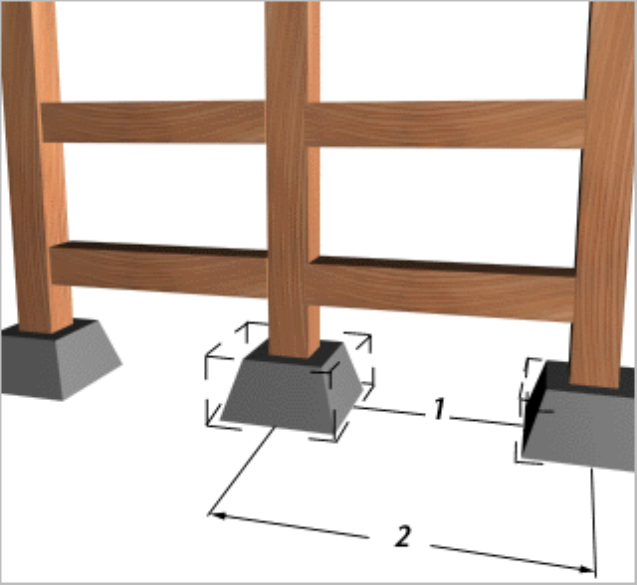
Context group
1. Edge-to-edge spacing
2. Center-to-center spacing
Edges Use this to specify that spacing is determined from the facing edges
of each object's bounding box.
Centers Use this to specify that spacing be determined from the center of
each object's bounding box.
Follow Use this to align the pivot points of the distributed objects to the
tangent of the spline.
Type of Object group
Determines the type of copies made by the Spacing tool. The default is Copy.
You can copy, instance on page 7818 , or reference on page 7910 objects.
932 | Chapter 7 Moving, Rotating, and Scaling Objects
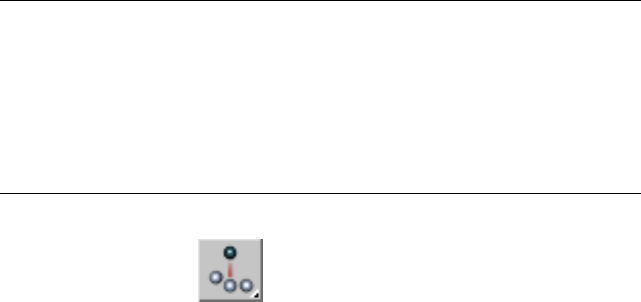
Copy Distributes copies of the selected object to the specified position.
Instance Distributes instances of the selected object to the specified position.
Reference Distributes references of the selected object to the specified
position.
TIP You can use compound shapes containing multiple splines as the spline path
for distributing objects. Before creating shapes, turn off Start New Shape under
Shapes on the Create panel. Then create your shapes. 3ds Max adds each spline
to the current shape until you click the Start New Shape button so that it's checked.
When you select the compound shape so that the Spacing tool can use it as a
path, objects are distributed along all of the splines of the compound shape. For
example, you might find this technique useful in spacing light standards along a
path defined by separated splines.
Clone and Align Tool
Extras toolbar > Clone and Align Tool (on Array flyout)
Tools menu > Clone and Align
The Clone And Align tool lets you distribute source objects based on the
current selection to a second selection of destination objects. For example,
you can populate several rooms simultaneously with the same furniture
arrangement. Similarly, if you import a CAD file that contains 2D symbols
that represent chairs in a conference room, you can use Clone And Align to
replace the symbols with 3D chair objects en masse.
The distributed objects can be copies, instances on page 7818 , or references
on page 7910 of the current selected object. You determine the number of clones
or clone sets by specifying any number of destination objects. You can also
specify position and orientation alignment of the clones on one, two, or three
axes, with optional offsets.
You can use any number of source objects and destination objects.
You can pick objects within an XRef scene as destination objects.
With multiple source objects, Clone And Align maintains the positional
relationships among the members of each cloned group, aligning the selection
center with the destination's pivot.
Clone and Align Tool | 933

Procedures
To use the Clone And Align tool:
1Create or load an object or objects to be cloned, as well as one or more
destination objects.
2Select the object or objects to be cloned.
3Open the Clone And Align dialog.
NOTE The order of steps 2 and 3 can be reversed.
4Do either of the following:
■Click Pick once and then click each destination object in turn. Next,
click Pick again to turn it off.
■Click Pick List and then use the Pick Destination Objects dialog to
pick all destination objects simultaneously.
5On the Clone Parameters rollout, choose the type of clone, and, if
appropriate, how to copy the controller. For details, see Clone Options
Dialog on page 965 .
6Use the Clone Parameters rollout settings to specify position, orientation,
and scale options.
7At any time, when Pick is off, you can change the source selection in a
viewport. This causes the dialog to lose focus; click it again to regain focus
and refresh the viewport preview of the clone operation.
8To make the clones permanent, click Apply, and then click Cancel or the
close button (X, in upper-right corner) to close the dialog.
934 | Chapter 7 Moving, Rotating, and Scaling Objects
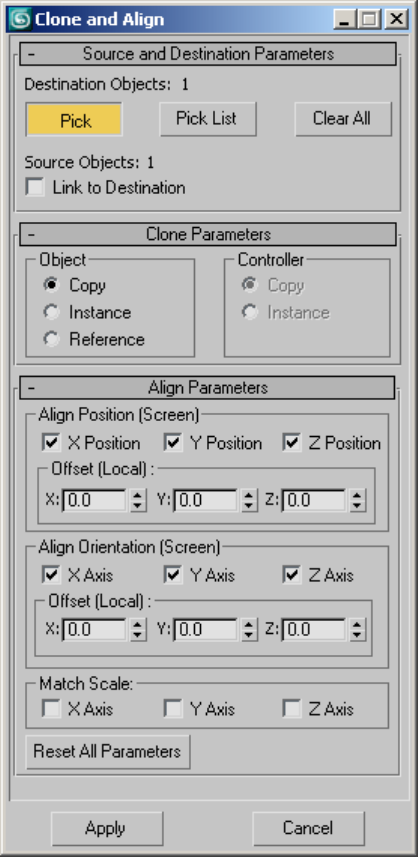
Interface
The Clone and Align tool takes the form of a non-modal dialog; it remains
open while you work in the viewports. While the dialog is active, the results
of the current settings appear as a preview in the viewports. Because of the
Clone and Align Tool | 935
dialog's non-modal nature, you can change the selection of source and
destination objects on the fly and see the results immediately in the viewports.
When the dialog focus is lost by activating another dialog or clicking in a
viewport (that is, its title bar is gray rather than blue), the preview no longer
appears in the viewports. To make the cloned objects permanent, click Apply
when the dialog is active.
Source and Destination Parameters rollout
Designate source objects by selecting them in a viewport. If you do this with
the Clone And Align dialog open, the dialog loses focus; click the dialog to
regain focus and update the settings.
Destination Objects [label] This read-only field shows the number of
destination objects. To change this value, use Pick, Pick List, and Clear.
Pick When on, each object you click in the viewports is added to the list of
destination objects. Click again to turn off after picking all destination objects.
To qualify as a valid destination object, an object must:
■not have been designated as a source or destination object.
■be selectable (frozen objects can't be selected).
■not be a temporary cloned object.
Pick List Opens the Pick Destination Objects dialog, which lets you pick all
destination objects simultaneously, by name. In the dialog, highlight the
destination objects, and then click Pick.
Clear All Removes all destination objects from the list. Available only when
at least one destination object is designated.
Source Objects [label] This read-only field shows the number of source
objects. To change this value, keep the dialog open, make sure Pick is off, and
then select source objects in the viewports. When you click the dialog, the
field updates.
Link to Destination Links each clone as a child of its destination object.
Clone Parameters rollout
These settings let you determine the type of clone to create, and, if appropriate,
how to copy the controller. For details, see Clone Options Dialog on page 965
.
936 | Chapter 7 Moving, Rotating, and Scaling Objects
Align Parameters rollout
The Align Position and Align Orientation group names are followed by the
current reference coordinate system on page 896 , in parentheses, which they
use as the coordinate system for positioning and aligning the clones. When
the View coordinate system is active, alignment uses the World coordinate
system.
The Offset parameters always use each destination object's Local coordinate
system.
Align Position group
X/Y/Z Position Specifies the axis or axes on which to align the clones'
position. Turning on all three options positions each set of clones at the
respective destination object's location.
X/Y/Z Offset The distance between the destination object's pivot and the
source object's pivot (or source objects' coordinate center). For an Offset value
to take effect, the respective Position check box must be on.
Align Orientation group
X/Y/Z Orientation Specifies the axis or axes about which to align orientation.
Turning on all three options aligns each set of clones' orientation fully with
that of the respective destination object.
X/Y/Z Offset The angle by which the source objects are rotated away from
the destination object's orientation about each axis. For an Offset value to
take effect, the respective Orientation check box must be on.
Match Scale Use the X Axis, Y Axis, and Z Axis options to match the scale
axis values between the source and destination.
This matches only the scale values you'd see in the coordinate display on
page 7325 . It does not necessarily cause two objects to be the same size. Matching
scale causes no change in size if none of the objects has previously been scaled.
Reset All Parameters Returns all settings in the Align Parameters rollout to
their default values.
Apply Generates the clones as permanent objects. After clicking Apply, you
can use Clone And Align to generate additional clones, using the results of
previous clonings as source or destination objects if you like.
Cancel Aborts the current cloning operation and closes the dialog.
Clone and Align Tool | 937

Align Flyout
Main toolbar > Align flyout
The Align flyout, available from the Main toolbar on page 7284 , provides access
to six different tools for aligning objects. These are, from top to bottom:
Align on page 938
Quick Align on page 944
Normal Align on page 945
Place Highlight on page 948
Align Camera on page 950
Align to View on page 951
Align
Main toolbar > Align (on Align flyout)
Keyboard > Alt+A
Interface on page 943
938 | Chapter 7 Moving, Rotating, and Scaling Objects
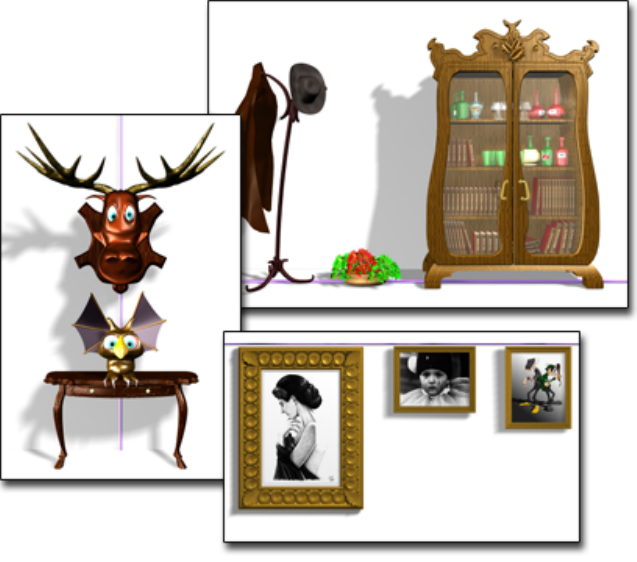
Clicking Align , available from the Align flyout on page 938 , then selecting
an object, displays the Align dialog, which lets you align the current selection
to a target selection. The name of the target object appears in the title bar of
the Align dialog. When performing sub-object alignment, the title bar of the
Align dialog reads "Align Sub-Object Selection."
Aligning objects along an axis
Left: X position, center
Upper right: Y position, minimum
Lower right: Y position, maximum
You can align the position and orientation of the bounding box on page 7736
of the source object to the bounding box of a target object.
You can use the Align tool with any selection that can be transformed. If an
axis tripod is displayed, you can align the tripod (and the geometry it
represents) to any other object in the scene. You can use this to align an
object’s pivot point.
Align | 939

You can use objects within an XRef scene as references with all alignment
tools on the Align flyout, except Align to View.
When performing sub-object alignment, the Current Object options and the
Match Scale boxes are disabled. If you plan to align orientation for sub-objects,
first switch to Local transform mode on the main toolbar so that the axis
tripod is properly aligned with your sub-object selection.
Other alignment tools on the Align flyout are Quick Align on page 944 ,
Normal Align on page 945 , Place Highlight on page 948 , Align to Camera on
page 950 , and Align to View on page 951 .
Procedures
To align an object with a point object:
1Create a point helper object and position it at a target location in your
scene. Rotate it as necessary to adjust final orientation.
2Select a source object.
3 On the Main toolbar, click Align, or choose Tools > Align.
The Align cursor appears attached to a pair of cross hairs.
4Move the cursor over the point object and click.
The Align Selection dialog appears. If necessary, move the dialog out of
the way so you can see the active viewport.
5In the Align Position group, turn on X Position.
The selected source object shifts to align with the X axis of the point
object.
6Turn on Y Position and Z Position.
The source object moves so its center is at the point object.
7Turn on X Axis, Y Axis, and Z Axis in the Align Orientation group to
reorient the object to match the coordinates of the point.
To align objects by position and orientation:
1Select a source object (the object to move into alignment with the target
object).
940 | Chapter 7 Moving, Rotating, and Scaling Objects

2 On the Main toolbar, click Align, or choose Tools > Align.
The Align cursor appears. When over an eligible target object, the cursor
also shows crosshairs.
3Position the cursor over the target object and click.
The Align Selection dialog appears. By default, all options in the dialog
are turned off.
4In the Current Object and Target Object groups, choose Minimum, Center,
Pivot Point, or Maximum.
These settings establish the points on each object that become the
alignment centers.
5Begin alignment by turning on any combination of X Position, Y Position,
and Z Position.
The source object moves in relation to the target object, along the axes
of the reference coordinate system. Setting all three moves the objects as
close as possible, given the Current Object and Target Object settings.
6In the Align Orientation group, turn on any combination of X Axis, Y
Axis, or Z Axis.
The source object realigns accordingly. If the objects already share an
orientation, turning on that axis has no effect. Once two axes are aligned
in orientation, the third is automatic.
To align a gizmo to another object:
1Display the gizmo level of the Sub-Object selection.
2 On the Main toolbar, click Align, or choose Tools > Align.
3Choose Tools > Align.
4Click to select a target object in the viewport. (You can select the same
object containing the gizmo to align the gizmo to a part of its own object.)
5Use the available settings in the Align dialog to adjust the transformation
of the gizmo.
Align | 941

To align a sub-object selection of geometry to another object:
1Do one of the following:
■Convert the object to an editable mesh, and then make the sub-object
selection at any level.
■Apply a Mesh Select or Poly Select modifier, make a sub-object
selection, apply an XForm modifier (The Mesh/Poly Select modifier
by itself doesn't allow transforms.), and then activate the Gizmo
sub-object level of the XForm modifier.
2 On the Main toolbar, click Align, or choose Tools > Align, and
then select a target object.
3Use the Align dialog controls to perform the alignment.
942 | Chapter 7 Moving, Rotating, and Scaling Objects
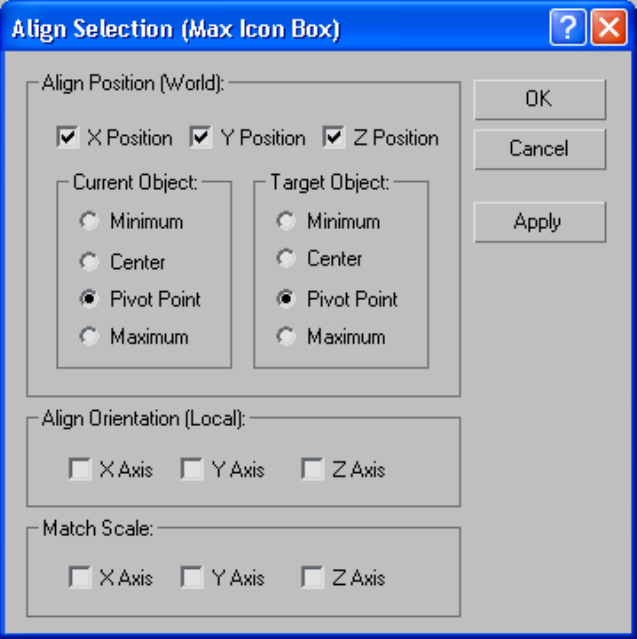
Interface
Align Position group
X/Y/Z Position Specifies the axis or axes on which to perform the alignment.
Turning on all three options moves the selection to the target object's location.
Current Object/Target Object groups
Specify the points on the objects' bounding boxes to use for the alignment.
You can choose different points for the current object and the target object.
For example, you can align the current object's pivot point on page 7895 with
the center of the target object.
Align | 943

Minimum Aligns the point on the object's bounding box with the lowest X,
Y, and Z values with the chosen point on the other object.
Center Aligns the center of the object's bounding box with the chosen point
on the other object.
Pivot Point Aligns the object's pivot point with the chosen point on the
other object.
Maximum Aligns the point on the object's bounding box with the highest
X, Y, and Z values with the chosen point on the other object.
Align Orientation (Local) group
These settings let you match the orientation of the local coordinate systems
between the two objects on any combination of axes.
This option is independent of the position alignment settings. You can leave
the Position settings alone and use the Orientation check boxes to rotate the
current object to match the orientation of the target object.
Position alignment uses world coordinates on page 7975 , while orientation
alignment uses local coordinates. on page 7830
Match Scale group
Use the X Axis, Y Axis, and Z Axis options to match the scale axis values
between the two selected objects. This matches only the scale values you'd
see in the Transform Type-In on page 874 . It does not necessarily cause two
objects to be the same size. There will be no change in size if neither of the
objects has previously been scaled.
Quick Align
Main toolbar > Quick Align (on Align flyout)
Tools menu > Quick Align
Keyboard > Shift+A
Quick Align lets you instantly align the position of the current selection to
that of a target object. If the current selection is a single object, Quick Align
uses the two objects' pivots on page 7895 . If the current selection comprises
944 | Chapter 7 Moving, Rotating, and Scaling Objects

multiple objects or sub-objects, Quick Align aligns the source's selection center
on page 907 with the pivot of the target object.
Procedures
To use Quick Align:
1Select one or more objects or sub-objects to align.
2Press Shift+A or choose Quick Align from the Tools menu or Main toolbar
> Align flyout.
The mouse cursor turns into a “lightning-bolt” symbol. When positioned
over an acceptable alignment target, a crosshairs symbol also appears.
3Click an object to which to align the selection from step 1.
The alignment is performed.
Normal Align
Main toolbar > Normal Align (on Align flyout)
Tools menu > Normal Align
Keyboard > Alt+N
Normal Align uses the Normal Align dialog to align two objects based on the
direction of the normal on page 7863 of a face or selection on each object. To
open the Normal Align dialog, select the object to be aligned, click a face on
the object, and then click a face on a second object. Upon releasing the mouse,
the Normal Align dialog appears.
If you use Normal Align while a sub-object selection is active, only that
selection is aligned. This is useful when aligning sub-object selections of faces,
since otherwise there's no valid face normal for the source object.
Normal Align respects smoothing groups and uses the interpolated normal,
based on face smoothing. As a result, you can orient the source object face to
any part of the target surface, rather than having it snap to face normals.
For an object with no faces (such as helper objects, space warps, particle
systems, and atmospheric gizmos), Normal Align uses the Z axis and origin
of the object as a normal. Thus, you can use a Point object on page 2544 with
Normal Align.
Normal Align | 945

Other alignment tools on the Align flyout are Align on page 938 , Quick Align
on page 944 , Place Highlight on page 948 , Align to Camera on page 950 , and
Align to View on page 951 .
Procedures
To align normals:
1Select a source object. This is the object that moves during alignment.
2 Click Normal Align on the Main toolbar, or choose Tools > Normal
Align.
3Drag across the surface of the source object.
The Normal Align cursor appears, attached to a pair of cross hairs. A blue
arrow at the cursor indicates the current normal.
4Move the cursor and blue arrow until you locate the normal you want
to use, then release.
The blue arrow remains as reference to the source normal.
5Drag across the surface of the target object.
A green arrow at the cursor indicates the current normal.
6Move the cross hairs and green arrow until you locate the normal you
want to use as a target, then release.
The source object moves into alignment with the target normal, and the
Normal Align dialog appears.
7Do one of the following:
■Click OK to accept the alignment.
■Using the dialog, make modifications to the alignment before clicking
OK.
■Click Cancel Align to cancel the alignment procedure.
946 | Chapter 7 Moving, Rotating, and Scaling Objects
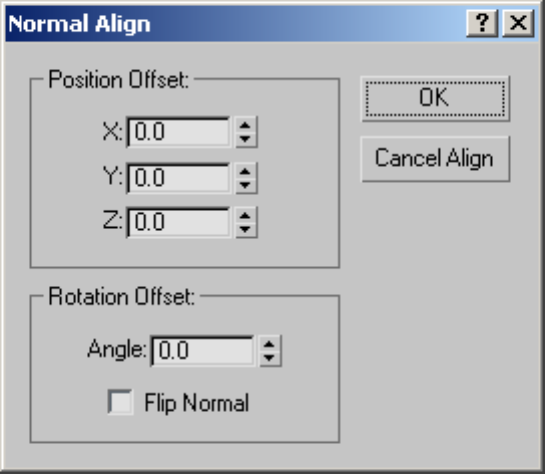
Interface
The Normal Align dialog lets you adjust or cancel the current alignment, and
contains the following controls:
Position Offset group
Lets you translate the source object perpendicular to the normal on the X, Y
or Z axes.
X/Y/Z These three fields let you affect how much of an offset will be given
to the selected faces.
Rotation Offset group
Lets you rotate the source object about the normal's axis. You see the rotation
in real time.
Angle This field lets you define the angle for the rotational offset.
Flip Normal Determines whether the source normal matches the target
normal's direction. This defaults to off, since you usually want the two normals
to have opposing directions. When you turn this on or off, the source object
flips 180 degrees.
Normal Align | 947
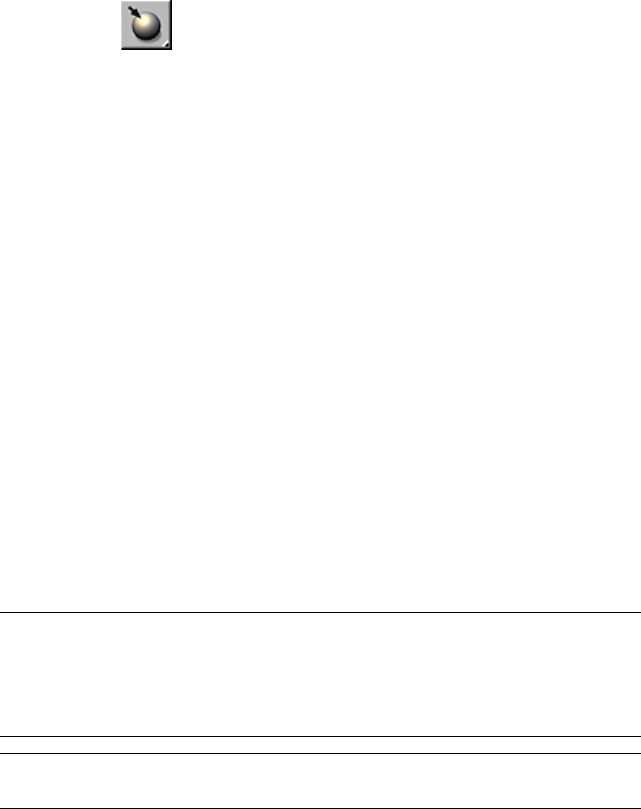
OK/Cancel Align The Cancel button is labeled Cancel Align to make it clear
that you're not only canceling the settings in the dialog, but canceling the
original transform on page 7958 of the source object.
Place Highlight
Main toolbar > Place Highlight (on Align flyout)
Tools menu > Place Highlight
Keyboard > Ctrl+H
Place Highlight, available from the Align flyout on page 938 , enables you to
align a light or object to another object so that its highlight or reflection can
be precisely positioned.
In Place Highlight mode, you can click and drag the mouse around in any
viewport. Place Highlight is a viewport-dependent function, so use the viewport
that you're going to be rendering. As you drag the mouse in the scene, a ray
is shot from the mouse cursor into the scene. If it hits a surface, you see the
surface normal on page 7863 at that point on the surface.
When you designate a surface, any selected objects are positioned along a line
that represents the ray reflected off the surface about the surface normal. The
objects are positioned along this line based on their original distance from
the surface point. For example, if the object is 100 units from the surface point
before being moved, it will be positioned 100 units from the surface point
along the reflected ray.
If the object is a light, the position of the highlight on the surface of the object
will be the surface point that you've chosen.
TIP Place Highlight works with any kind of selected object. It can be used to move
objects based on a combination of face normals and initial distance from the face.
You can also use Place Highlight with a selection set that contains more than one
object. All objects maintain their initial distance from the face. In this case it has
nothing to do with highlights, but is simply being used to position objects.
NOTE Highlight rendering depends on the material's specular properties and the
type of rendering you use.
948 | Chapter 7 Moving, Rotating, and Scaling Objects
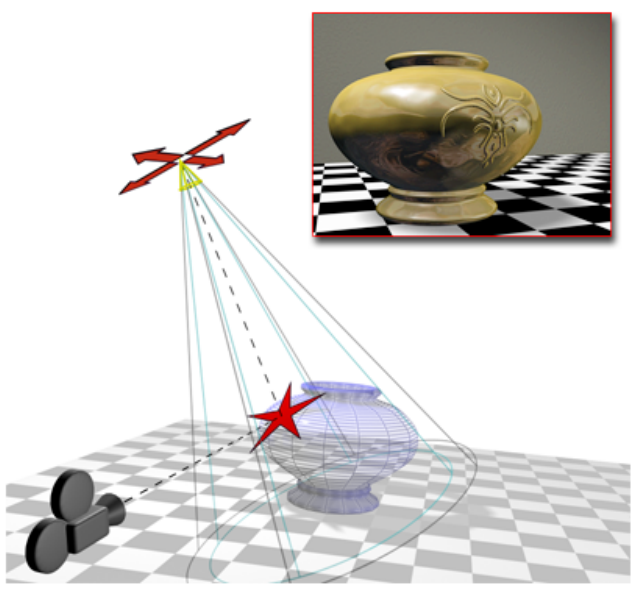
Place Highlight aligns a camera and a spotlight to the same face.
Other alignment tools on the Align flyout are Align on page 938 , Quick Align
on page 944 , Normal Align on page 945 , Align to Camera on page 950 , and
Align to View on page 951 .
Procedures
To position a light to highlight a face:
1Make sure the viewport you plan to render is active, and that the object
you want to highlight is visible in it.
The result of Place Highlight depends on what is visible in the viewport.
2Select a light object.
Place Highlight | 949

3 Click Place Highlight, or choose Tools > Place Highlight.
Choose Tools > Place Highlight.
If the button is not visible on the toolbar, choose it from the Align flyout.
4Drag over the object to place the highlight.
When you place an omni, free spot, or directional light, the software
displays a face normal for the face the mouse indicates.
When you place a target spotlight, the software displays the light's target
and the base of its cone.
5Release the mouse when the normal or target display indicates the face
you want to highlight.
The light now has a new position and orientation. You can see the
highlight illumination in shaded viewports that show the face you chose,
and when you render those views.
Align Camera
Main toolbar > Align Camera button (on Align flyout)
Tools menu > Align Camera
Align Camera, available from the Align flyout on page 938 , lets you align a
camera to a selected face normal.
Align Camera works similarly to Place Highlight on page 948 , except that it
operates on face normals instead of the angle of incidence, and occurs when
you release the mouse button instead of dynamically acting during the mouse
drag. Its purpose is to let you align a Camera viewport to a specified face
normal.
Other alignment tools on the Align flyout are Align on page 938 , Quick Align
on page 944 , Normal Align on page 945 , Place Highlight on page 948 , and
Align to View on page 951 .
Procedures
To use Align Camera:
1Select the camera used for the viewport you want to align.
950 | Chapter 7 Moving, Rotating, and Scaling Objects

2 Click Align Camera or choose Tools menu > Align Camera.
3In any viewport, drag the mouse over an object surface to choose a face.
The chosen face normal appears as a blue arrow beneath the cursor.
4Release the mouse to perform the alignment.
The software moves the camera so it faces and centers the selected normal
in the camera viewport.
Align to View
Main toolbar > Align to View (on Align flyout)
Tools menu > Align to View
Align to View, available from the Align flyout on page 938 , displays the Align
To View dialog, which lets you align the local axis of an object or sub-object
selection with the current viewport.
You can use Align to View with any selection that can be transformed.
Other alignment tools on the Align flyout are Align on page 938 , Quick Align
on page 944 , Normal Align on page 945 , Place Highlight on page 948 , and
Align to Camera on page 950 .
Procedures
To align the local axis of a selection with the current viewport:
1Select the objects or sub-objects to align.
2 Click Align to View.
3Specify the local axis of the selected object to align with the current
viewport's Z axis.
4Select the Flip check box when you switch the direction of the alignment.
The alignment takes place while the dialog is displayed.
5Click OK to complete the process.
Align to View | 951
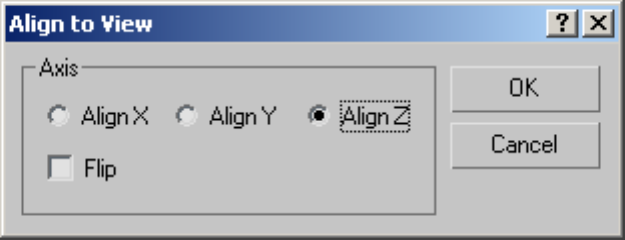
Interface
The Align to View dialog contains the following options:
Align X, Align Y, Align Z Specifies which local axis of the selected object will
be aligned with the current viewport's Z axis.
Flip Switches the direction of the alignment.
952 | Chapter 7 Moving, Rotating, and Scaling Objects
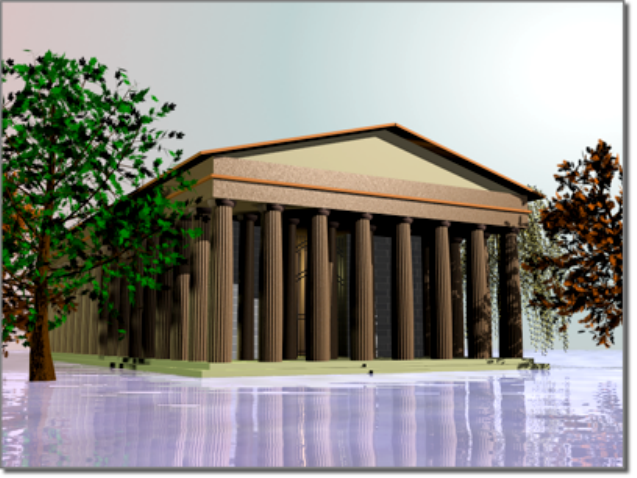
Creating Copies and
Arrays
With 3ds Max, you can quickly create multiple versions of one or more selected objects during
a transform operation. You do this by holding down the Shift key as you move, rotate, or scale
the selection.
Portico created from arrays of columns
8
953
The general term for duplicating objects is cloning. This section presents all the methods
and choices available for cloning objects. In addition to the transform method, the tools
include the following:
■Array lets you set all three transforms, in all three dimensions, at the same time. The
results are precise linear and circular arrays in 2D or 3D space.
■Mirror produces a "reflected" clone about one or more axes. If you mirror an object without
cloning, the result is a "flip" of the geometry, optionally to a new location.
■Snapshot lets you create clones equally spaced over time or distance, based on an
animation path.
■Spacing Tool distributes objects based on the current selection along a path defined by a
spline or pair of points.
You can animate any of the cloning techniques. These topics supply overview information,
as well as specifics of animation for each of them:
Techniques for Cloning Objects on page 958
Overview of Copies, Instances, and References on page 955
Using +Clone on page 968
■Cloning with Shift+Move on page 970
■Cloning with Shift+Rotate on page 972
■Cloning with Shift+Scale on page 975
Animating +Rotate and +Scale on page 977
Cloning Objects Over Time with Snapshot on page 979
Arraying Objects on page 981
■Using the Array Dialog on page 983
■Creating Linear Arrays on page 989
■Creating Circular and Spiral Arrays on page 993
Mirroring Objects on page 996
Using the Spacing Tool on page 998
954 | Chapter 8 Creating Copies and Arrays
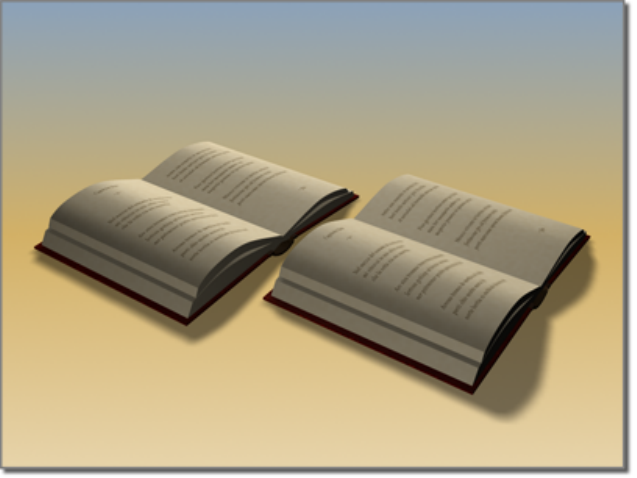
Overview of Copies, Instances, and References
To duplicate an object, you use one of three methods. For all three methods,
the original and clone (or clones) are identical at the geometry level. Where
the methods vary is in the way they handle modifiers (for example, Bend or
Twist).
An object can be a copy of another.
Copy method: Creates a completely separate clone from the original. Modifying
one has no effect on the other.
Instance method: Creates a completely interchangeable clone of the original.
Modifying an instanced object is the same as modifying the original.
Reference method: Creates a clone dependent on the original up to the point
when the object is cloned. Changing parameters for modifiers that were applied
to the object before the object was referenced, will change both objects.
However, a new modifier can be applied to one of the reference objects, and
it will affect only the object to which it is applied.
Depending on the method used to create them, cloned objects are called copies,
instances, or references.
Overview of Copies, Instances, and References | 955
The following discussion focuses on how you might use these methods.
Copies
Copies are the most familiar kind of clone object. When you copy an object,
you create a new, independent master object and data flow resulting in a new,
named object. The copy duplicates all of the data of the original object at the
time it is copied. The copy has no connection to the original object.
Example of Using Copied Objects
If you modeled a basic head shape and wanted to create a group of individual
characters, you would probably make a copy of the basic head shape each
time you started a new character. You could then model an individual nose,
mouth, and other features.
Copying Actively Linked Objects
When you copy objects that are actively linked through the File Link Manager
on page 6783 , the software automatically converts the copies to editable mesh
objects. If your selection contains several objects that instance another object,
the resulting copies also instance the same object.
Instances
Instances are alike not only in geometry, but also in every other way as well.
Instancing an object results in multiple named objects based on a single master
object. Each named object instance has its own set of transforms, space warp
bindings, and object properties, but it shares the object modifiers and master
object with the other instances. The data flow for an instance branches just
after evaluating object modifiers.
When you change one instance by applying or adjusting a modifier, for
example, all the other instances change with it.
Within 3ds Max, instances derive from the same master object. What you’re
doing "behind the scenes" is applying a single modifier to a single master
object. In the viewport, what you see as multiple objects are multiple instances
of the same definition.
Example of Using Instanced Objects
If you wanted to create a school of swimming fish, you might begin by making
many instanced copies of a single fish. You could then animate the swimming
956 | Chapter 8 Creating Copies and Arrays
motion by applying a Ripple modifier to any fish in the school. The whole
school would swim with exactly the same motions.
Instances of Actively Linked Objects
Creating instances of actively linked objects is not recommended. Reliability
issues can arise if the instanced object is deleted in the linked file.
References
References are based on the original object, as are instances, but can also have
their own unique modifiers. Like instances, references share, at minimum,
the same master object and possibly some object modifiers.
The data flow for a reference branches just after the object modifiers but then
evaluates a second set of object modifiers unique to each reference. When you
create references, 3ds Max displays a gray line, called the derived-object line, at
the top of the modifier stack for all clones. Any modification made below the
line is passed on to other references, and to the original object. New modifiers
added above the line are not passed on to other references. Changes to the
original object, such as in its creation parameters, are passed on to its
references.
This effect is useful for maintaining an original that will affect all its references,
while the references themselves can take on individual characteristics.
All shared modifiers reside below the derived-object line and are displayed in
bold. All modifiers unique to the selected reference reside above the
derived-object line and are not bold. The original object does not have a
derived object line: its creation parameters and modifiers are all shared, and
all changes to this object affect all references.
The results of changing or applying a modifier to a named object reference
depends on where in the modifier stack it is applied:
■Applying a modifier to the top of the modifier stack affects only the selected
named object.
■Applying a modifier below the gray line affects all references branching
above that line.
■Applying a modifier at the bottom of the modifier stack affects all references
derived from the master object.
Overview of Copies, Instances, and References | 957
References of Actively Linked Objects
Creating references of actively linked objects is not recommended. Reliability
issues can arise if the referenced object is deleted in the linked file.
Example of Using Referenced Objects
In the example of modeling heads, you might want to keep a family
resemblance in your characters. You could model basic features on the original,
then model specifics on each reference.
At some point, if you wanted to see what your characters would look like as
"cone-heads," you could apply a Taper modifier to the original head, and have
all the other characters take on the same feature. You could give the original
character a very pointed head, then apply a separate Taper to some referenced
characters to reduce the point toward normal.
For swimming fish, you might choose to make all members of the school as
referenced objects based on a single, original fish. You could still control the
swimming motion from the original fish, and also add modifiers to individual
fish in the school to vary their behavior.
Techniques for Cloning Objects
3ds Max provides several techniques for copying or duplicating objects; cloning
is the general term for this process. These techniques can be used to clone any
selection set.
■Clone
■Shift+Clone
■Snapshot
■Array
■Mirror
■Spacing Tool
■Clone and Align Tool
958 | Chapter 8 Creating Copies and Arrays
Shared Features
While each technique has distinct uses and advantages in cloning objects, in
most cases the cloning techniques share some similarities in how they work:
■You can apply a transform when you clone. New objects are moved, rotated,
or scaled as they are created.
■The transform is relative to the current coordinate system, axis constraint,
and transform center.
■When cloning creates new objects, you have the choice of making them
copies, instances, or references.
Each of the following items is discussed later in this chapter.
Clone
Using the Clone command on the Edit menu is the easiest method for copying
an object in place; no transformation is involved. See Clone on page 965 .
Techniques for Cloning Objects | 959
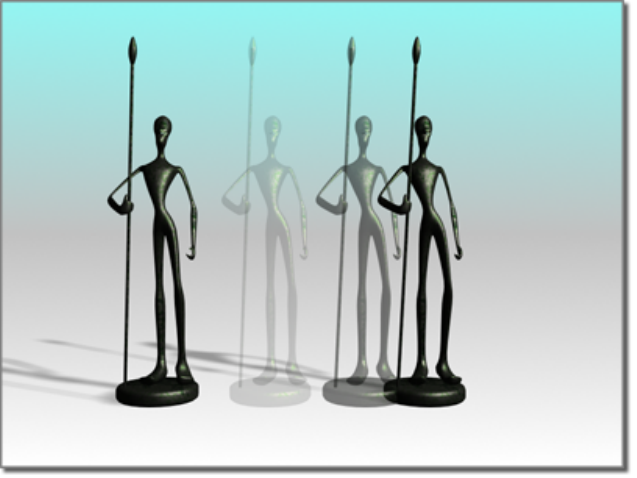
Shift+Clone
Shift+Clone clones an object when you transform it.
You can clone an object as you transform it interactively in the viewport. The
process is referred to as SHIFT+Clone on page 968 : the technique of holding
down the Shift key while transforming a selected object with the mouse.
Quick and versatile, this technique is probably the one you’ll use most often
to duplicate objects. Snap settings give you precise results.
How you set the center and axes for the transforms determines the arrangement
of the cloned objects. Depending on the settings, you can create both linear
and radial arrays.
You need a working knowledge of transform features to take full advantage
of Shift+Clone. See Using Transforms on page 862 .
960 | Chapter 8 Creating Copies and Arrays
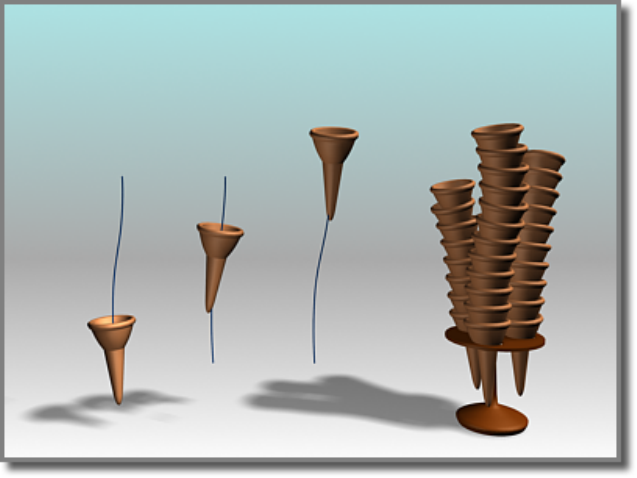
Snapshot
Using an ice-cream cone animated along a path, Snapshot creates a stack of cones.
Snapshot on page 921 clones an animated object over time. You can create a
single clone on any frame, or space multiple clones along the animation path.
The spacing is a uniform time interval; it can also be a uniform distance.
Techniques for Cloning Objects | 961
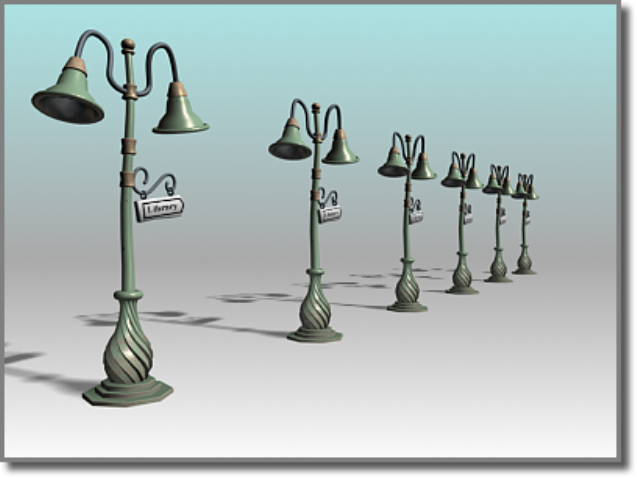
Array
A one-dimensional array
Array creates repeating design elements: for example, the gondolas of a Ferris
wheel, the treads of a spiral stair, or the battlements along a castle wall.
Array gives you precise control over all three transforms and in all three
dimensions, including the ability to scale along one or more axes. It is the
combination of transforms and dimensions, coupled with different centers,
that gives you so many options with a single tool. A spiral stair, for example,
would be a combination of Move and Rotate around a common center. Another
array using Move and Rotate might produce the interlocked links of a chain.
See Arraying Objects on page 981 .
962 | Chapter 8 Creating Copies and Arrays
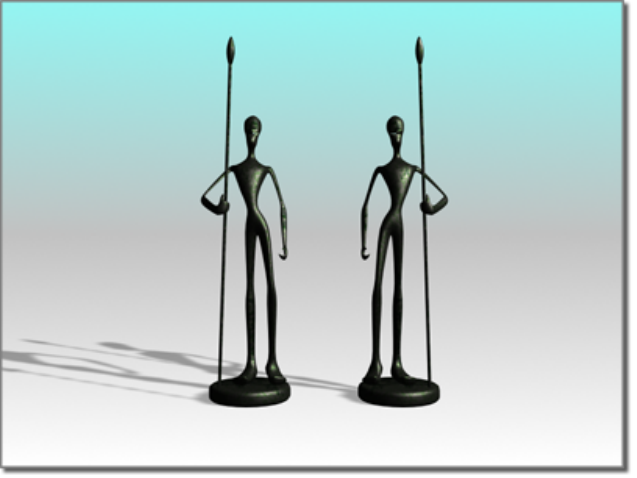
Mirror
Mirroring an object
Mirror produces a symmetrical copy around any combination of axes. There
is also a "No Clone" option that performs the mirror operation without
copying. The effect is a flip or move of the object to a new orientation.
Mirror has an interactive dialog. As you change settings, you see the effect in
the active viewport; in other words, a preview of what the mirror will look
like.
There is also a Mirror modifier that gives you parametric control of the mirror
effect.
See Mirroring Objects on page 996 .
Techniques for Cloning Objects | 963
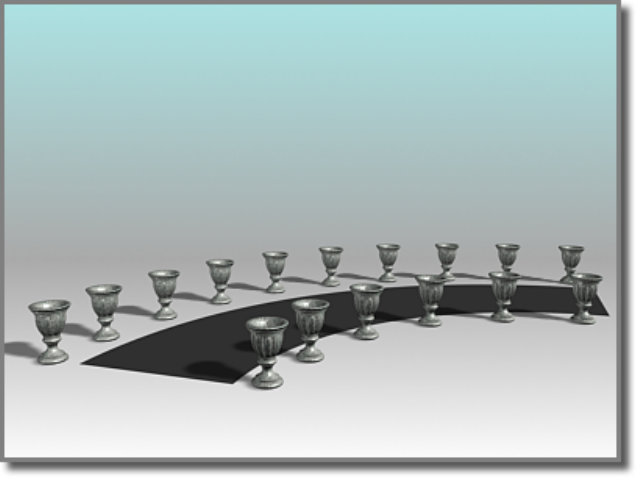
Spacing Tool
The Spacing Tool distributes the vases along the sides of the curved street.
The Spacing Tool distributes along a path defined by a spline or pair of points.
You define a path by picking a spline or two points and by setting a number
of parameters. You can also specify how the spacing between objects is
determined and whether the insertion points of the objects align to the tangent
of the spline.
See Spacing Tool on page 925 .
Clone and Align Tool
The Clone And Align tool lets you distribute source objects based on the
current selection to a second selection of destination objects. For example,
you can use Clone And Align to populate several rooms simultaneously with
the same furniture arrangement. Similarly, if you import a CAD file that
contains 2D symbols that represent chairs in a conference room, you can use
Clone And Align to replace the symbols with 3D chair objects en masse.
See Clone and Align Tool on page 933 .
964 | Chapter 8 Creating Copies and Arrays
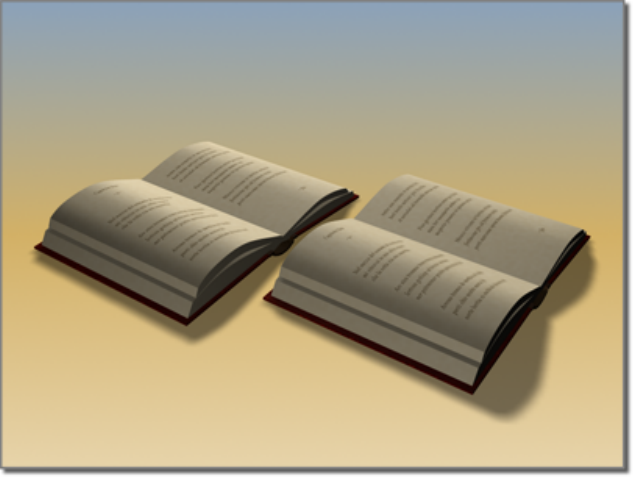
Clone
Make a selection. > Edit menu > Clone
Make a selection. > Hold down Shift key. > Move, rotate, or scale the selection
with the mouse.
Clone creates a copy, instance, or reference of an object.
With the Clone command you can create copies, instances, or references of
a selected object or a set of objects.
The Clone command on the Edit menu creates a single copy of your selection.
Alternatively, you can clone multiple copies by holding down the Shift key as
you move on page 888 , rotate on page 889 , or scale on page 891 your selection.
Either method displays the Clone Options dialog on page 965 .
Clone Options Dialog
Make a selection. > Edit menu > Clone
Clone | 965
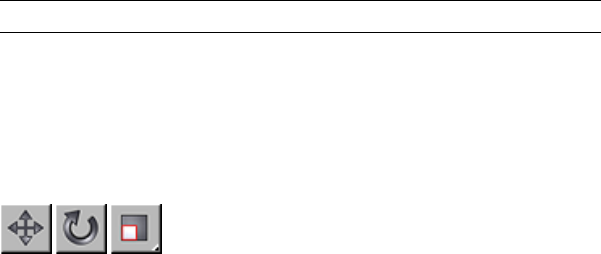
Make a selection. > Hold down Shift key. > Move, rotate, or scale the selection
with the mouse.
Clone creates a copy, instance on page 7818 , or reference on page 7910 of a
selected object or set of objects. The Clone command on the Edit menu creates
a single copy. You can clone multiple copies by holding down the Shift key
as you transform the selection.
Procedures
To clone an object without transforming it:
1Select an object, or set of objects.
2From the Edit menu, choose the Clone command.
3The Clone Options dialog opens.
NOTE All options are present except Number Of Copies.
4Change the settings or accept the defaults, and then click OK.
Each new, cloned object occupies the same space as the original. Select
a clone by name to move or modify it.
To clone and transform an object:
1On the main toolbar, click the Move, Rotate, or Scale
button.
2Select an object, multiple objects, group, or sub-object.
3Hold down the Shift key and drag the selection.
As you drag your selection, the clone is created, selected, and transformed.
The original object is deselected and unaffected by the transform.
When you release the mouse button, the Clone Options dialog displays.
4Change the settings or accept the defaults, and then click OK.
966 | Chapter 8 Creating Copies and Arrays
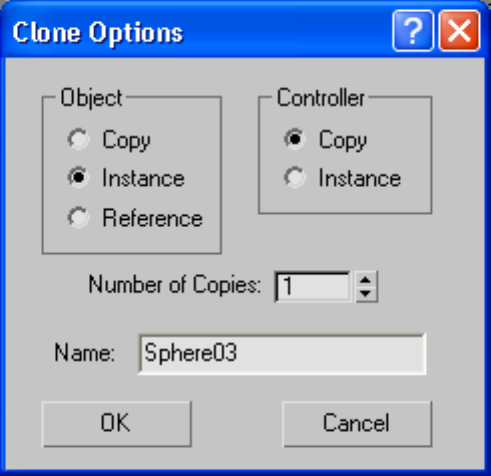
Interface
Object group
Copy Places a copy of the selected object at the specified position.
Instance Places an instance of the selected object at the specified position.
Reference Places a reference of the selected object at the specified position.
Controller group
Lets you choose to copy or instance the transform controllers on page 7712 of
the original object’s child objects. This option is available only when the
selection you are cloning includes two or more hierarchically linked objects
on page 7806 .
When cloning non-linked objects, transform controllers are simply copied.
Also, when cloning linked objects, the highest-level cloned object's transform
controller is simply copied. This option applies only to the transform
controllers of objects at levels below the top of the cloned hierarchy.
Copy Copies the cloned objects' transform controllers.
Clone Options Dialog | 967
Instance Instances the cloned objects' transform controllers below the top
level of the cloned hierarchy. With instanced transform controllers, you can
change the transform animation of one set of linked children, and
automatically have the change affect any cloned sets.
This allows you to animate all clones identically with a single animation setup.
For example, consider a scene containing three objects named Torso, Thigh,
and Calf. The objects are linked hierarchically so that Torso is the parent of
Thigh and Thigh is the parent of Calf. Say you select all three objects and then
clone them, and choose Clone Options > Controller > Instance. Thereafter, if
you transform either Thigh or Calf object, the corresponding object in the
other hierarchy is transformed identically, along with any child objects.
However, if you transform either Torso object, the other hierarchy is not
affected.
Number of Copies Specifies the number of copies of the object you want to
create. Available only when you Shift+Clone an object.
Using Shift+Clone to generate multiple copies applies the transform successively
to each additional copy. If you Shift+Move an object and specify two copies,
the second copy is offset from the first copy by the same distance that the
first copy is offset from the original. For Rotate, two copies of the rotated
object are created, with the second copy rotated twice as far as the first. For
Scale, two copies of the scaled object are created, with the second copy scaled
from the first copy by the same percentage that the first copy was scaled from
the original.
Name Displays the name of the cloned object.
You can use this field to change the name; additional copies use the same
name followed by a two-digit number, starting at 01 and incrementing by
one for each copy. So, for instance, if you Shift+Move an object and then
specify the name building and two copies, the first copy will be named building
and the second will be named building01.
Using Shift+Clone
Shift+Clone is the primary way to duplicate objects in 3ds Max. You hold
down the Shift key and drag during any of the standard transform operations:
Move, Rotate, or Scale.
968 | Chapter 8 Creating Copies and Arrays
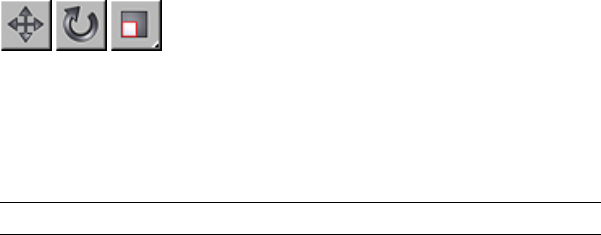
To Shift+Clone an object:
1On the main toolbar, click the Move, Rotate, or Scale
button.
2Select a transform coordinate system and constraints. Each transform
carries its own settings. To avoid surprises, always click the transform
button first, and then set your transform coordinate system and
constraints.
NOTE You can also use the Transform Gizmo to set axis constraints.
3Select the object or set of objects you want to clone. The selection can
be a single object, multiple objects, a group, or a sub-object selection.
4Hold down the Shift key and drag the selection to apply the transform.
As you drag, a clone is created and selected; it is now the object being
transformed. The original object is no longer selected and is unaffected
by the transform.
When you release the mouse button, the Clone Options dialog appears. Change
settings in this dialog or accept the defaults, and then click OK.
Shift+Clone uses the Clone Options dialog on page 965 for any transform you
choose.
See also:
■Cloning with +Move on page 970
■Cloning with +Rotate on page 972
■Cloning with +Scale on page 975
Animating Shift+Clone
You can animate any Shift+Clone operation. See Animating with Shift+Rotate
and Shift+Scale on page 977 .
Cloning Without Transforming
Cloning objects with Shift+Clone requires transforming them at the same
time, by moving, rotating, or scaling them. In some cases, you might want to
Using Shift+Clone | 969

clone an object without transforming it in any way. The Edit menu Clone
command gives you this option, which lets you create only one clone at a
time.
To clone objects without transforming:
1Select the object or objects to clone.
2Choose Edit menu > Clone. The Clone Options dialog appears. This is
the same dialog used with Shift+Clone except that there's no Number Of
Copies setting. The Clone command lets you create only one copy.
3Change settings in this dialog or accept the defaults, and click OK.
NOTE The cloned object occupies the exact same space as the original, and
is selected when cloning is complete. Use Select By Name on page 168 to
select the original or reselect the clone.
Cloning with Shift+Move
Cloning objects while moving them is quick and easy. It produces a linear
array of two or more objects.
970 | Chapter 8 Creating Copies and Arrays
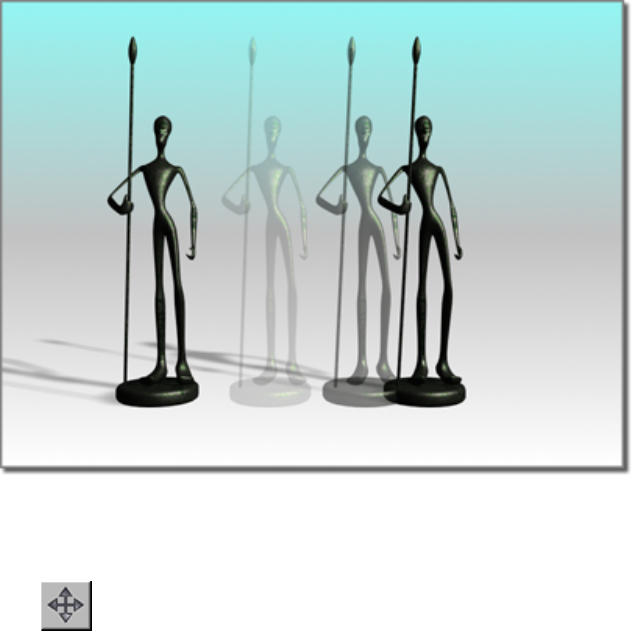
Shift+Move creates a clone in a different location.
To clone with Shift+Move:
1Click the Move button on the main toolbar.
2Choose a coordinate system and axis constraint.
3Make the selection you want to clone.
4Hold down Shift and drag to move a clone of the selection away from the
original.
5Choose the number of copies you want to make on the Clone Options
dialog, and whether you want them to be copies, instances, or references.
Cloning with Shift+Move | 971
About Arrays Created with Shift+Move
Multiple clones produced by Shift+Move form an equally spaced linear array
with these characteristics:
■The line of the array runs from the center of the original through the
centers of the clones.
■The distance between each neighboring pair of copies is the same the
distance between the original and the first clone.
By using snaps as you move the selection, you can make precise arrays.
An example of the Shift+Move array is a picket fence. From a single picket,
you can generate long runs of fencing. You can array the fence along a major
axis of the home grid, then group the pickets, rotate them to a particular angle,
and move them into position.
You can also make three-dimensional arrays with Shift+Move. The main choice
is the combination of axes to allow movement off the construction plane. For
example, to build a stairway, you can create a box that forms the top step,
then use Shift+Move to copy it diagonally downward, using an array to create
a downward flight.
Cloning with Shift+Rotate
Cloning objects while rotating them produces a variety of effects, depending
on how you set up the transformation.
972 | Chapter 8 Creating Copies and Arrays
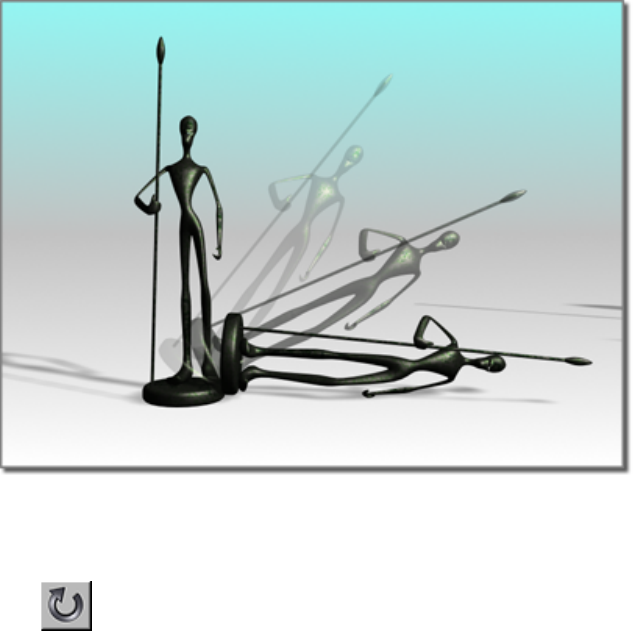
Shift+Rotate creates a clone with a different orientation.
To clone with Shift+Rotate:
1Click the Rotate button on the main toolbar.
2Choose a coordinate system, transformation center, and axis constraint.
3Make the selection you want to clone.
4Hold down the Shift key and drag to rotate the selection.
5Choose the number of copies you want to make on the Clone Options
dialog, and whether you want them to be copies, instances, or references.
Effects of Transform Settings
Where you locate the transform center determines how 3ds Max positions
clones when using Shift+Rotate.
■For all settings, the direction of rotation is constrained by the active axis
or axes of the viewport’s coordinate system.
Cloning with Shift+Rotate | 973
■Each clone is rotated from the previous one by the same amount as the
first clone from the original.
Local Pivot at Center
An object’s default pivot point is often located at its center or its base. When
you use Shift+Rotate around an object’s default pivot point, the clones overlap
evenly as each one is rotated the same amount. This is true for multiple objects
with a local-pivot setting, since each object uses its own local center.
Clones of a circular object, like a sphere or cylinder, can be overlaid exactly
on the original. You might need to move them away from the original to see
them.
With angle snap on page 2523 set to divide a circle evenly, you can produce
complex symmetrical objects from simple ones. For example, you can clone
a tetrahedron around one axis, then clone the new set about another axis to
produce a faceted star.
Local Pivot at a Distance
When you separate the local pivot from the original, clones create a wheel-like
arrangement. Long shapes like petals or blades, cloned with the center near
one end, can create flowers or propellers. See Adjust Pivot Rollout on page
3399 .
You can move the local pivot any distance from the object, creating large
circular arrays. Since direct animation is limited to the local pivot, this is a
key technique in animating circular arrays. See Animating +Rotate and +Scale
on page 977 .
Selection Center
For either single or multiple objects, the selection center is the geometric
center of the bounding box on page 7736 enclosing the entire selection. Clones
are arrayed around this center, forming wheel-like arrays.
For a single object, this center is usually different from its local center, but
the effects are similar to those based on a local pivot.
Coordinate Center
Using the coordinate center, Shift+Rotate can produce circular arrays of any
size.
974 | Chapter 8 Creating Copies and Arrays
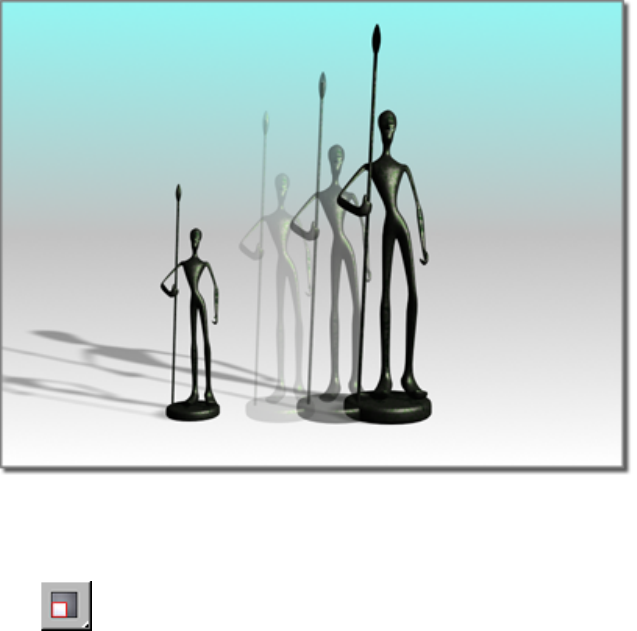
The rotation takes place around the center of the home grid, the screen, or
whichever coordinate system you choose. While clones can be created this
way, the process cannot be directly animated. For details on overcoming this
limitation, see Animating +Rotate and +Scale on page 977 .
Cloning with Shift+Scale
Cloning objects while scaling them can produce a variety of nested objects
and arrays, depending on the center you choose.
Shift+Scale creates a clone of a different size.
To clone with Shift+Scale:
1Click a Scale button on the main toolbar.
2Choose a coordinate system, axis constraint, and transform center.
3Make the selection you want to clone.
4Hold down Shift and drag to scale the selection.
Cloning with Shift+Scale | 975
5Use the Clone Options dialog to choose the number of clones you want
to make and whether you want them to be copies, instances, or references.
Effects of Transform Settings
Transform settings determine how 3ds Max distributes clones of a selection
during Shift+Scale. In all scaling operations, the transform center acts as the
center of scaling:
■When clone objects decrease in size, they shrink toward the transform
center.
■When clone objects increase in size, they expand away from the transform
center.
The distance between cloned objects is scaled like the clones themselves, based
on the initial distance from the original to the first clone. The spacing increases
or decreases proportionately with respect to the transform center.
Nested Copies
When the selection center is used as the transform center for a single object,
scaling occurs symmetrically around that center, producing nested copies.
■As you scale in toward the center, smaller and smaller copies are created.
■In the other direction, the original object is enclosed by increasingly larger
copies.
Variations are possible, depending on the type of scale and axis limitations.
For example, you can scale a flat box into a progressively stepped pyramid by
using Squash on page 894 and cloning inward on the Z axis.
Offset Centers
For Shift+Scale, any center other than the local pivot has the effect of creating
an array of progressively scaled objects. Again, objects scale down in size
toward the center, while increasing in size further away. However, this effect
is limited by the particular scale option and the axis constraints, as discussed
next.
976 | Chapter 8 Creating Copies and Arrays

Axis Constraints
Uniform Scale is unaffected by axis constraints, which you can set with the
Transform Gizmo. Copies are always arrayed in or out from the center of the
current coordinate system.
For Non-Uniform Scale and Squash, scaling occurs only along the axis or axes
set with the restricted axes.
NOTE The Restrict To ... buttons (also called the Axis Constraints buttons) are
available on the Axis Constraints toolbar on page 7288 , which is off by default.
You can toggle display of this toolbar by right-clicking an empty area of a toolbar
and choosing Axis Constraints from the Customize Display right-click menu on
page 7479 .
Animating Shift+Rotate and Shift+Scale
When the Auto Key button on page 7344 is on, the transform center defaults
to local pivot, and the Use Center flyout on page 904 on the toolbar is
unavailable. If you choose one of the other centers and activate Auto Key, the
center returns to the local pivot. This means you can’t directly animate about
a non-local pivot center with Shift+Rotate and Shift+Scale. For example, you
can't use this method to create clones in an arc or circular array around a
common center.
Using Non-Local Centers
To use a center separate from the object you’re cloning, you can do any of
the following:
■Use a dummy object.
■Offset the local pivot.
■Change the default animation center.
Using a Dummy Object as Center
In this procedure, you use the axis tripod of the dummy object as the center
for rotation or scale.
Animating Shift+Rotate and Shift+Scale | 977
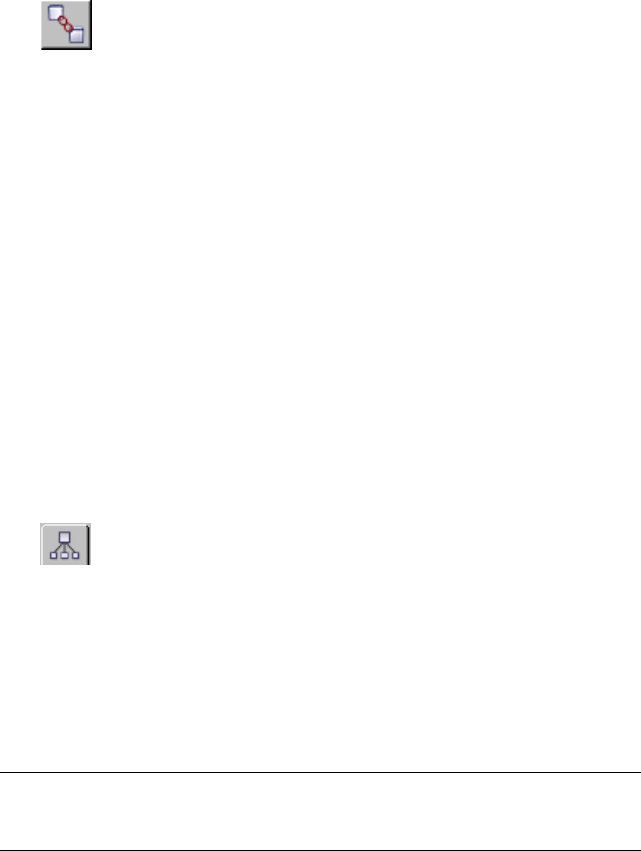
To use a dummy object as center:
1Create a dummy object on page 2531 at the center of rotation or scaling.
2 Link the object or objects you want to clone to the dummy object,
which becomes the parent.
3Select both the dummy and the objects, then transform them with
Shift+Rotate or Shift+Scale.
■For Shift+Rotate, the dummy’s center becomes the pivot.
■For Shift+Scale, the dummy and selected objects scale together toward
the center of the dummy.
For details of dummy object use in hierarchies, see Using Dummy Objects on
page 3288 .
Offsetting the Local Pivot
In this procedure, you move the object’s pivot to the center of rotation or
scale. This works much like using a dummy object.
To offset the local pivot:
1Select the object whose pivot you wish to move.
2 On the Hierarchy command panel, choose Pivot and then turn
on Affect Pivot Only.
3Move the local pivot of the original object to another location in your
scene.
4On the Hierarchy panel, click Affect Pivot Only again to turn it off.
Shift+Rotate or Shift+Scale now animates around the offset center. This
works with the default setting for local center.
NOTE Moving the local pivot can adversely affect linking and inverse kinematics.
If this is a possibility, consider changing the default axis instead of moving the
local pivot.
978 | Chapter 8 Creating Copies and Arrays

To change the default axis while animating:
In this procedure, you set 3ds Max to allow animation of transforms about
any center on the Use Center flyout.
1Choose Customize menu > Preferences and click the Animation tab of
the Preference dialog.
2In the Animate group, turn off Local Center During Animate.
This changes the default and makes all the transform center options
available when animating. You can now animate around either the
selection or transform coordinate center, as well as local pivot.
NOTE Changing the default setting animates the rotation you see in viewports
as a rotation plus translation, which might not be the effect you wanted.
Cloning Objects Over Time with Snapshot
The Snapshot tool on page 921 lets you clone an object along its animation
path. You can make a single clone at any frame, or multiple clones spaced
over a selected number of frames.
Cloning Objects Over Time with Snapshot | 979
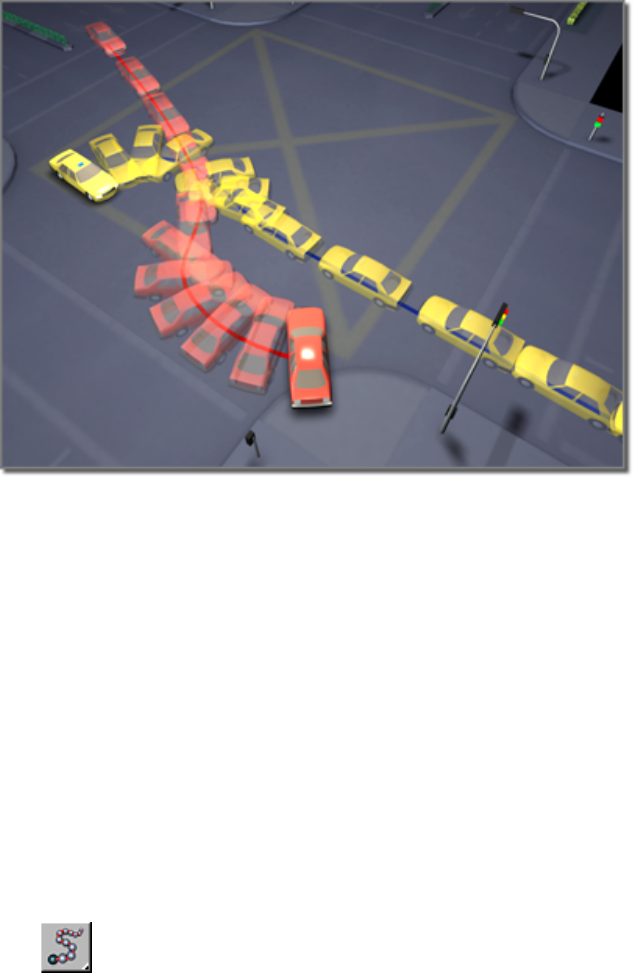
Using car models animated along paths, Snapshot creates an image of a collision.
Snapshot can also clone a particle system's particles.
Snapshot spaces the clones equally in time. Adjustments in Track View let
you space the clones equally along the path instead.
Like other clone techniques, Snapshot creates copies, instances, or references.
You can also choose a mesh option.
To clone an object with Snapshot, the object must already be animated. You
can use Snapshot from any frame on the path. The Auto Key button has no
effect on Snapshot, since Snapshot creates static clones, not animation. This
is the general procedure:
To clone an object with Snapshot:
1Select an object with an animation path, or a particle system. The
animation can result from applying transforms, controllers, or any
combination of effects.
2 On the Array flyout on page 911 click Snapshot, or choose Tools
menu > Snapshot to display the Snapshot dialog.
980 | Chapter 8 Creating Copies and Arrays
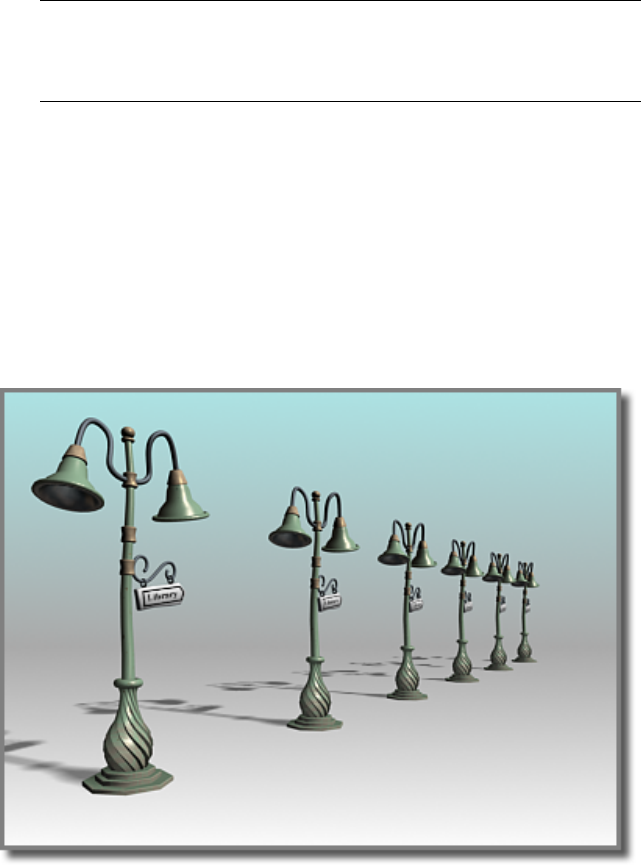
NOTE The Array flyout is on the Extras toolbar, which is off by default. You
can toggle display of this toolbar by right-clicking an empty spot on the main
toolbar and choosing Axis Constraints from the Customize Display right-click
menu on page 7479 .
3Set parameters in the dialog, and click OK.
Arraying Objects
Array is a dedicated tool for cloning and precisely transforming and positioning
groups of objects in one or more spatial dimensions. For each of the three
transforms (move, rotate, and scale), you can specify parameters for individual
objects in the array, or for the array as a whole. Many results you can get with
Array would be laborious or impossible using Shift+Clone techniques.
A one-dimensional array
Creating an Array
This is the general procedure. For more details, see these topics:
Arraying Objects | 981
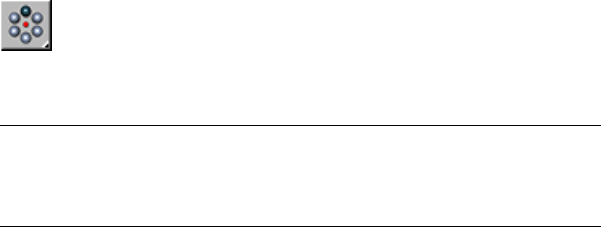
Using the Array Dialog on page 983
Creating Linear Arrays on page 989
Creating Circular and Spiral Arrays on page 993
To create an array:
1Select one or more objects to be in the array.
2Choose a coordinate system and transform center.
3 Click Array on the Array flyout, or choose Array on page 915 from
Tools menu.
The Array dialog appears.
NOTE The Array flyout is on the Extras toolbar, which is off by default. You
can toggle display of this toolbar by right-clicking an empty spot on the main
toolbar and choosing Axis Constraints from the Customize Display right-click
menu on page 7479 .
4Set array parameters on this dialog, then click OK.
Reuse of Array Settings
Generally you should approach Array creation as an iterative process. The
dialog settings are not interactive, so you get feedback only after creating the
array. By revising the current settings and repeating the array, you develop a
solution that meets your needs.
After creating an array and checking its result, you can undo the array using
Edit menu > Undo Create Array or Ctrl+Z. This leaves the original selection
set in place.
Repeating an Array
When you create an array, object selection moves to the last copy or set of
copies in the array. By simply repeating current settings, you create a seamless
continuation of the original array.
During a session, 3ds Max maintains all the dialog settings for your current
array.
Array settings are saved only during the current session, not with the file. Be
sure you’ve finished an array before you quit 3ds Max.
982 | Chapter 8 Creating Copies and Arrays
General Considerations
When you create an array, keep these points in mind:
■Array is relative to the current viewport settings for coordinate system and
transform center.
■Axis constraints do not apply, because Array allows you to specify
transforms along all axes.
■You can animate array creation. By changing the default Animate
preferences setting, you can activate all the transform center buttons,
allowing direct animation around either the selection or coordinate center,
as well as local pivot. For information about changing the default setting,
see the procedure, To change the default axis while animating on page
? .
■To make an array of a hierarchically linked object, select all the objects in
the hierarchy before you click Array.
Using the Array Dialog
The Array dialog provides two main control areas where you set the important
parameters: Array Transformation and Array Dimensions.
You can set parameters in any order, but in practice it’s useful to start with
Array Transformation. This creates the basic building block for the larger array,
as defined by Array Dimensions.
These topics discuss specific strategies for using these controls:
Creating Linear Arrays on page 989
Creating Circular and Spiral Arrays on page 993
Using the Array Dialog | 983
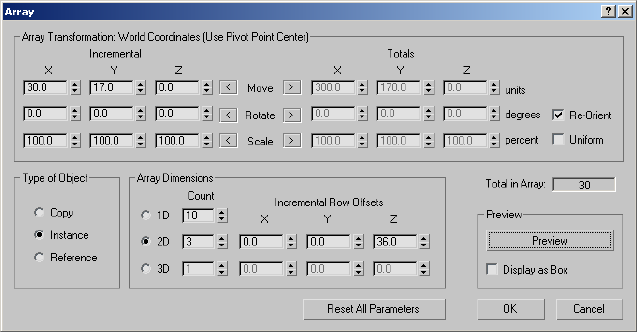
See also:
■Array on page 915
Array Transformation
This area lists the active coordinate system and transform center. It’s where
you set the transforms that define the first row of the array. You decide here
on the distance, rotation, or scale of individual elements, and along what
axes. You then repeat this row in other dimensions to produce the finished
array.
Move, Rotate, and Scale Transforms
You set Move, Rotate, and Scale parameters along any of the three axes of the
current coordinate system.
■Move is set in current units. Use a negative value to create the array in the
negative direction of the axis.
■Rotate is set in degrees. Use a negative value to create the array in a
clockwise direction around the axis.
■Scale is set as a percentage. 100 percent is full size. Settings below 100
decrease the size, and above 100 increase it.
984 | Chapter 8 Creating Copies and Arrays
Incremental and Totals
For each transform, you have the choice of whether to apply the transforms
successively to each newly created element in the array or to the overall array.
For example, if you set Incremental > X > Move to 120.0 and Array Dimensions
> 1D > Count to 3, the result is an array of three objects, each of whose
transform centers is 120.0 units apart. However, if you set Totals > X > Move
to 120.0 instead, the three elements are spaced 40.0 units apart for a total
array length of 120.0 units.
■Click arrows on either side of the transform labels to choose between
Incremental or Totals.
Incremental and Totals settings are toggles for each transform. When you set
a value on one side, the other side is unavailable. However, the unavailable
value updates to show the equivalent setting.
Incremental: Parameters set on this side apply to individual objects in the
array. Here are examples:
■An Incremental Move X setting of 25 specifies a spacing of 25 units on the
X axis between centers of arrayed objects.
■An Incremental Rotate Z setting of 30 specifies a progressive rotation of
30 degrees on the Z axis for each object in the array. In the finished array,
each object is rotated 30 degrees farther than the one before it.
Totals: Parameters set on this side apply to the overall distance, number or
degrees, or percentage scale in the array. Here are examples:
■A Totals Move X setting of 25 specifies a total distance of 25 units on the
X axis between the centers of the first and last arrayed objects.
■A Totals Rotate Z setting of 30 specifies a combined rotation of 30 degrees
on the Z axis divided equally among every object in the array.
Type of Object
Copy Creates new array members as copies of the originals.
Instance Creates new array members as instances of the originals.
Reference Creates new array members as references of the originals.
For further information, see Overview of Copies, Instances, and References
on page 955 .
Using the Array Dialog | 985
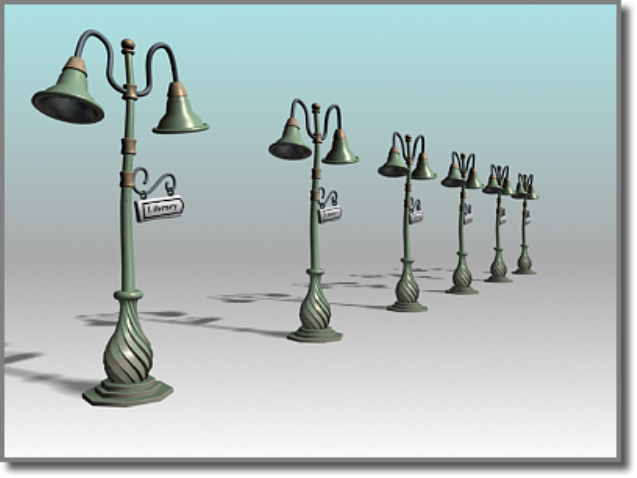
Array Dimensions
The Array Dimensions controls determine the number of dimensions used in
the array and the spacing between the dimensions.
Count: The number of objects, rows, or layers in each dimension.
1D: One-dimensional arrays form a single line of objects in 3D space, like a
line of columns. 1D Count is the number of objects in a row. Spacing for these
objects is defined in the Array Transformation area.
A one-dimensional array, with 1D Count=6
2D: Two-dimensional arrays form a layer of objects along two dimensions,
like the rows of squares on a chess board. 2D Count is the number of rows in
the array.
986 | Chapter 8 Creating Copies and Arrays
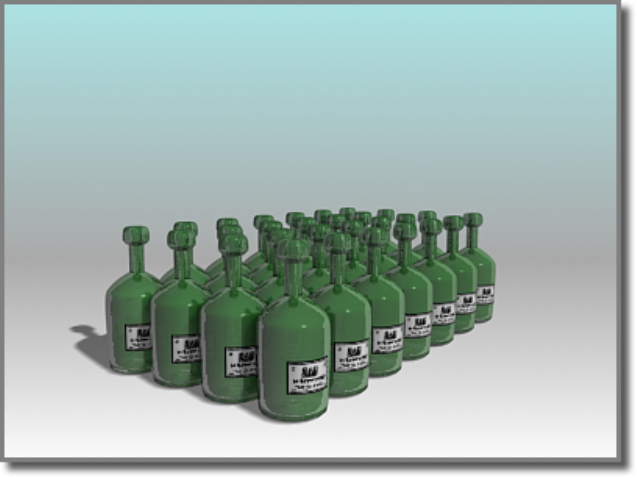
A two-dimensional array, with 1D Count=7 and 2D Count=4
3D: Three-dimensional arrays form multiple layers of objects in 3D space, like
neatly stacked boxes. 3D Count is the number of layers in the array.
Using the Array Dialog | 987
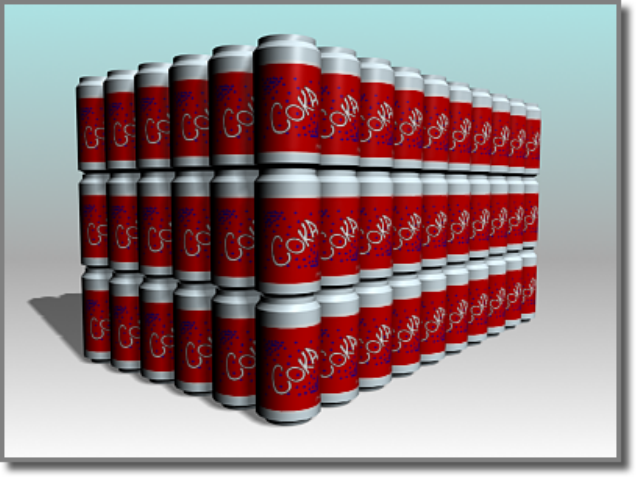
A three-dimensional array, with 1D Count=10, 2D Count=6, 3D Count=3
Incremental Row Offsets
These parameters become available when you choose a 2D or 3D array. These
are distances along any of the three axes of the current coordinate system.
■If you set a Count value for 2D or 3D, but no row offsets, the array is created
with overlapping objects. You need to specify at least one offset distance
to prevent this.
■If some objects appear to be missing from the array, it is possible that some
objects have been created exactly on top of other objects in the array. To
determine whether this has occurred, use Select By Name on page 168 to
see the full listing of objects in your scene. If objects are on top of one
another and you don't want this effect, click Ctrl+Z to undo the array, and
try again.
988 | Chapter 8 Creating Copies and Arrays
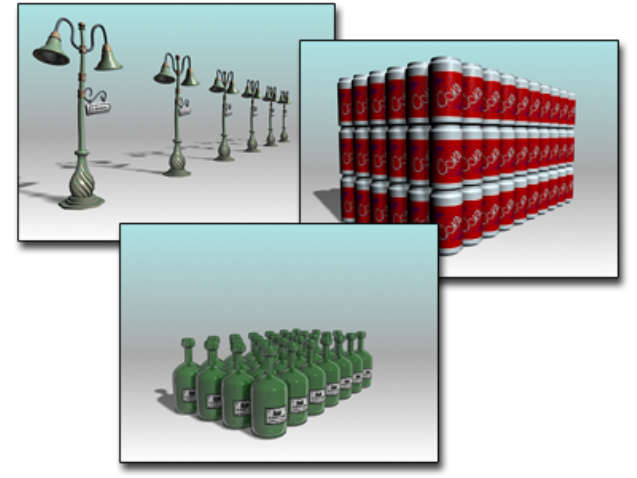
Creating Linear Arrays
A linear array is a series of clones along one or more axes. A linear array can
be anything from a line of trees or cars to a stairway, a picket fence, or a length
of chain. Any scene requiring repeated objects or shapes is a candidate for a
linear array.
Examples of linear arrays
For an explanation of interface terms used here, see Using the Array Dialog
on page 983 . For the basic steps in making an array, see Arraying Objects on
page 981 .
Creating Simple Linear Arrays
The simplest 2D linear array is based on moving a single object along a single
axis. These are the basic choices to make on the Array dialog.
Make these choices in the Array Transformation group:
■Use Incremental Move settings where you know the spacing you want
between objects.
Creating Linear Arrays | 989
■Use Totals Move settings when you know the overall space or volume you
want the array to occupy.
■For either of these two types of arrays, enter a value for one axis. Leave the
other transforms at their default values.
Make these choices in the Array Dimensions group:
■Choose 1D.
■Enter a Count value for the number of objects in the array. The Total In
Array field updates to show you the current total of objects in the array
you are designing.
■Click OK to create a linear array along the chosen axis, with the number
of objects specified by Count.
2D and 3D Linear Arrays
Arrays in 2D and 3D have the same Array Transformation group setup as 1D,
with the addition of Incremental Row Offsets settings for moving the additional
dimensions apart.
■Set 2D or 3D and enter a Count value.
If you set 3D, the 2D values also become available. Both Count values are
1 by default, which has the same effect as 1D. Set the 2D and 3D Count
values greater than 1 to produce a more complex array.
■Set a nonzero value for at least one Incremental Row Offsets setting for 2D
and 3D. Otherwise, there will be no separation between the 1D row and
the new clones.
A wide variety of linear arrays are possible. Experiment with moving along all
three axes and varying the row offsets in 2D and 3D.
990 | Chapter 8 Creating Copies and Arrays
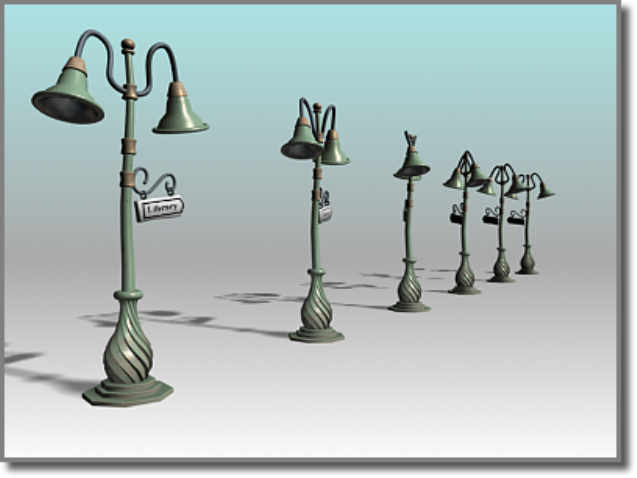
Using Rotation in Linear Arrays
Linear array with elements rotated about their Y axis
You can rotate elements in a linear array by applying a Rotate value for a
specified axis. When you add rotation to a linear array, the choice of transform
center becomes important.
Creating Linear Arrays | 991
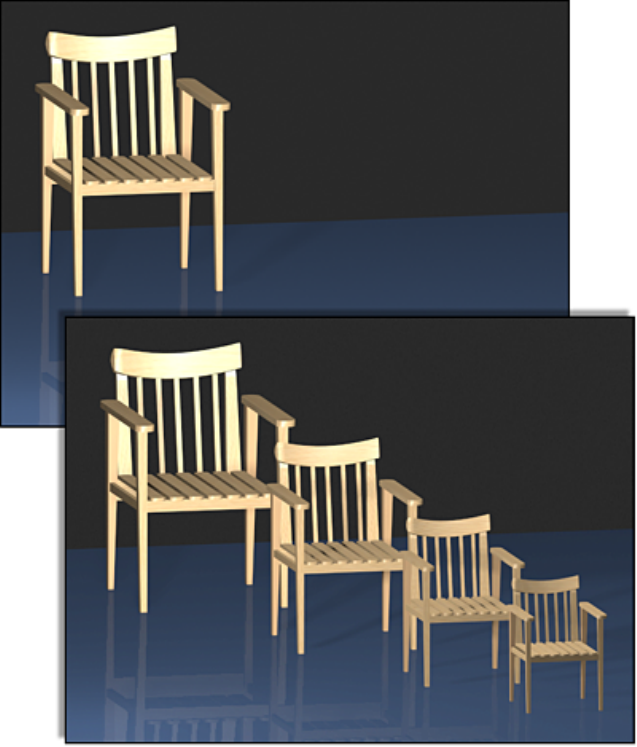
Using Scale in Linear Arrays
Linear array with progressive scaling
When you apply a Scale factor, 3ds Max scales each copy from the previous
copy. Objects in the array become progressively smaller or larger, as in the
illustration.
992 | Chapter 8 Creating Copies and Arrays
Scale and Movement in Nested Arrays
Using only Scale settings and the local pivot of an object produces nested
arrays, like Russian dolls, just as it does when you Shift+Scale from the local
pivot. However, with the Array tool, you can add movement as well. This
means you can create increasingly larger or smaller copies and array them at
the same time.
Using Uniform Scaling
By default, all axes are available for scaling.
If you turn on Uniform, only the Scale X field is active; the Y and Z fields are
unavailable. The X value is applied as uniform scaling on all axes of the arrayed
objects.
Creating Circular and Spiral Arrays
Creating circular and spiral arrays typically involves some combination of
moving, scaling, and rotating copies along one or two axes and around a
common center. The effects can vary from the uniform radial arrangement
of bolts on a wheel hub to the complex geometry of a spiral staircase. You can
model many circular patterns with these techniques.
See Using the Array Dialog on page 983 for an explanation of interface terms
used here. See Arraying Objects on page 981 for the basic steps in making an
array.
Using a Common Center
Both circular and spiral arrays require a common center for the arrayed objects.
This can be the world center, the center of a custom grid object, or the center
of the object group itself. You can also move the pivot point of an individual
object and use that as the common center.
Creating Circular and Spiral Arrays | 993
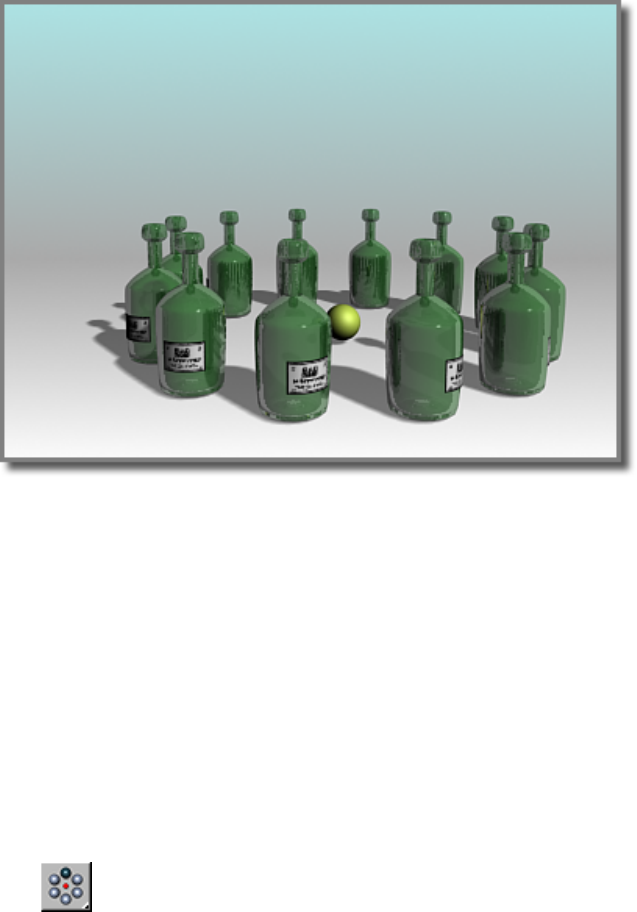
Circular Arrays
A circular array
Circular arrays are similar to linear arrays, but based on rotation around a
common center rather than movement along an axis. The following procedure
makes a circle of objects on the XY plane of the home grid with the Z axis as
the center.
To create a circular array:
1On the main toolbar, choose a transform center to become the center of
the array. In this case, choose Use Transform Coordinate Center so the
center of the grid becomes the array center.
2Select an object and position it at some distance from the center of the
grid.
This distance is the radius of the finished circle.
3 Choose Array from the Array flyout or the Tools menu to display
the Array dialog.
994 | Chapter 8 Creating Copies and Arrays
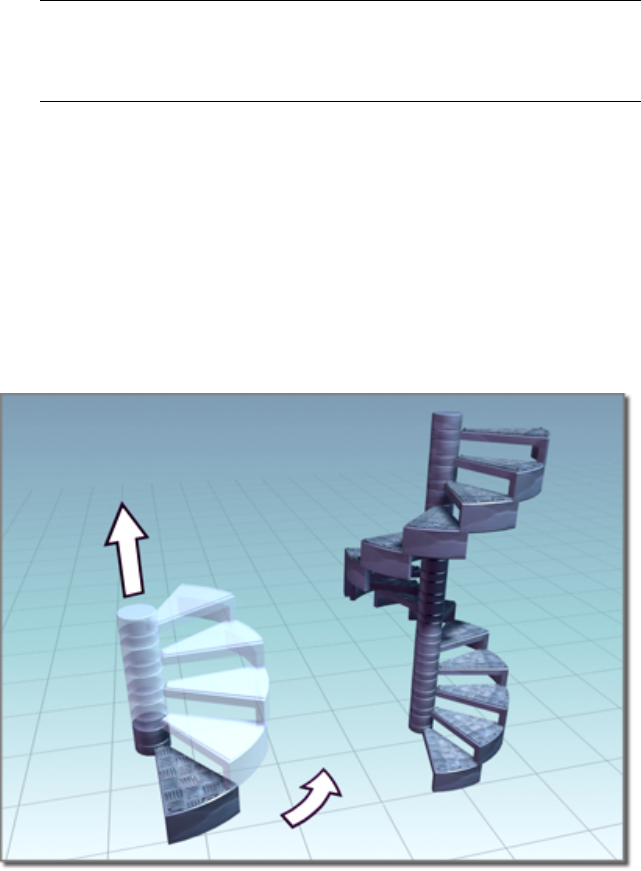
NOTE The Array flyout is on the Extras toolbar, which is off by default. You
can toggle display of this toolbar by right-clicking the main toolbar and
choosing Axis Constraints from the Customize Display right-click menu on
page 7479 .
4On the Array dialog, enter 360 in the Totals Rotate Z field.
This is the total rotation for the array, a complete circle. To create a partial
circle, enter a smaller value.
5Choose 1D and enter a Count value (this can be any number) and click
OK.
3ds Max arrays that number of clones within the total rotational angle
you specify.
Spiral Arrays
A spiral array
The simplest spiral arrays are rotated circular arrays with a movement along
the central axis. The same circle is formed, but now the circle rises upward.
Creating Circular and Spiral Arrays | 995
If Z is the central axis, enter a value for Incremental Move Z. Each clone is
then moved upward this amount as the circle is formed.
Rotation in Spiral Arrays
In spiral arrays, the direction of rotation determines the direction of the spiral:
which way it winds up or down.
Enter a positive rotation for a counterclockwise spiral.
Enter a negative rotation for a clockwise spiral.
Reorienting an Array
By default, each object, when copied into the array, rotates around its own
center to follow the main rotation around the common center. This is
controlled by the Re-Orient option.
To cause objects to maintain their original orientation while being rotated,
turn off Re-Orient. In effect, objects remain "facing the same direction" as the
original object.
Mirroring Objects
The Mirror tool uses a dialog that either creates a mirrored clone of a selected
object, or mirrors the orientation of the object without creating a clone. You
can preview the effects of settings before committing to the operation.
996 | Chapter 8 Creating Copies and Arrays
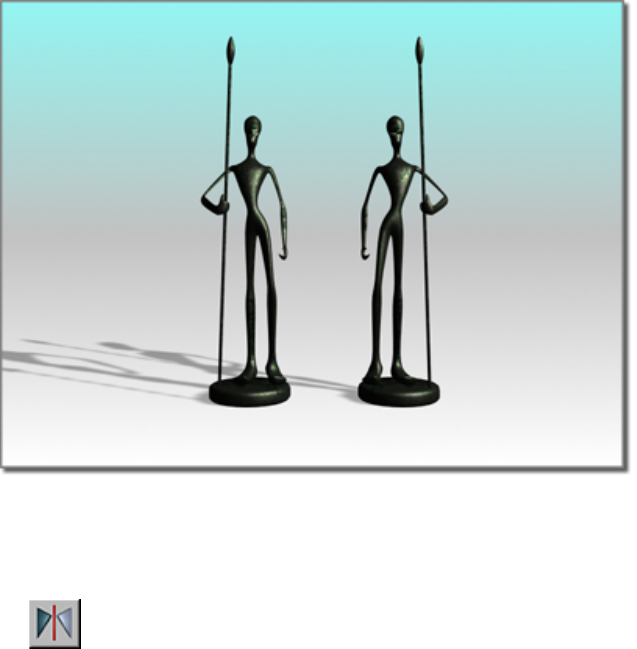
Mirroring an object
This is the general procedure for mirroring an object. Begin by selecting the
object.
■Click the Mirror button on the main toolbar, or choose Tools menu
> Mirror. This displays the Mirror dialog. The title bar indicates the
coordinate system currently in use.
For information on the Mirror dialog options, see Mirror Selected Objects
on page 911 .
Mirrored Arrays
You can combine the Mirror and Array tools by using them in succession. An
entire array can be mirrored, or you can set up mirrored objects before creating
an array.
Mirroring Objects | 997
Animating Mirror
When you use Mirror with Auto Key turned on, you see the transition occur
as the mirrored object moves into place. For example, a cylinder mirrored to
the other side of an axis appears to flatten and reshape itself. The object is, in
fact, scaled from 100% to 0% to –100%. This effect is not visible unless the
mirror operation is animated.
Mirror Modifier
The Mirror modifier on page 1471 provides a parametric method of mirroring
an object or sub-object selection within the modifier stack. You can apply the
Mirror modifier to any type of geometry. You can animate the mirror effect
by animating the modifier’s gizmo.
Using the Spacing Tool
The Spacing Tool distributes objects based on the current selection along a
path defined by a spline or pair of points. The distributed objects can be copies,
instances, or references of the current selected object. You define a path by
picking a spline or two points and by setting a number of parameters. You
can also specify how the spacing between objects is determined and whether
the insertion points of the objects align to the tangent of the spline.
998 | Chapter 8 Creating Copies and Arrays
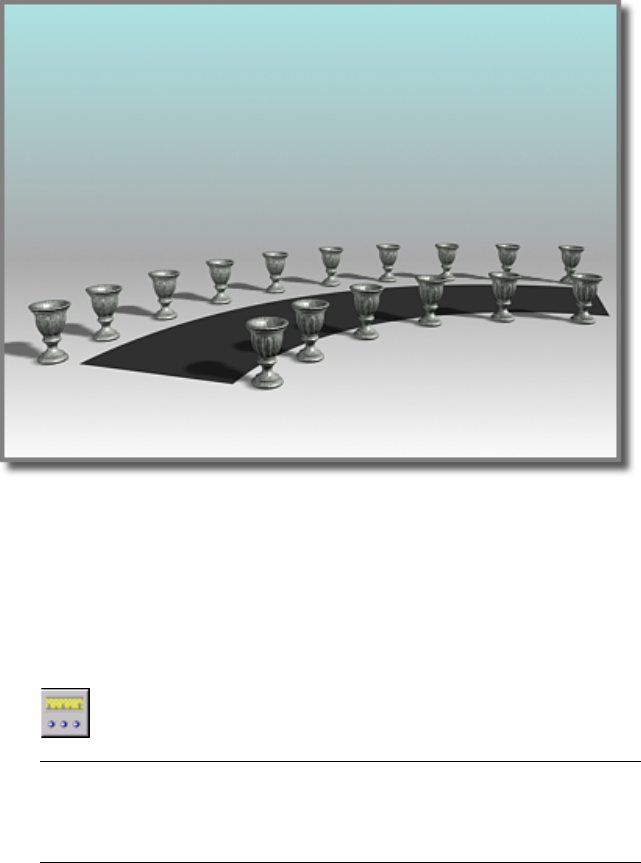
The Spacing Tool distributes the vases along the sides of the curved street. The vases
are all at the same distance from each other; fewer of them appear on the shorter
side.
For details on the Spacing Tool parameters, see Spacing Tool on page 925 .
To distribute objects along a path:
1Select one or more objects to distribute.
2 Choose Spacing tool from the Array flyout or the Tools menu.
NOTE The Array flyout is on the Extras toolbar, which is off by default. You
can toggle display of this toolbar by right-clicking an empty area on the main
toolbar and choosing Axis Constraints from the Customize Display right-click
menu on page 7479 .
3On the Spacing Tool dialog, click Pick Path or Pick Points to specify a
path.
If you click Pick Path, select a spline from your scene to use as the path.
Using the Spacing Tool | 999
If you click Pick Points, click a start point and an end point to define a
spline as the path. When you’re finished with the Spacing Tool, 3ds Max
deletes this spline.
4From the drop-down list at the bottom of the Parameters group, choose
a spacing option.
The parameters available for Count, Spacing, Start Offset, and End Offset
depend on the spacing option you choose.
5Specify the number of objects to distribute by entering a Count value, or
by using the spinner.
6Depending on the spacing option you choose, adjust the spacing and
offsets.
7In the Context group, choose one of the following:
■Edges specifies that spacing be determined from the facing edges of
each object’s bounding box.
■Centers specifies that spacing be determined from the center of each
object’s bounding box.
8To align the insertion points of the distributed objects to the tangent of
the spline, turn on Follow.
9In the Type Of Object group, choose the type of object to output (copy,
instance, or reference) and click Apply.
1000 | Chapter 8 Creating Copies and Arrays
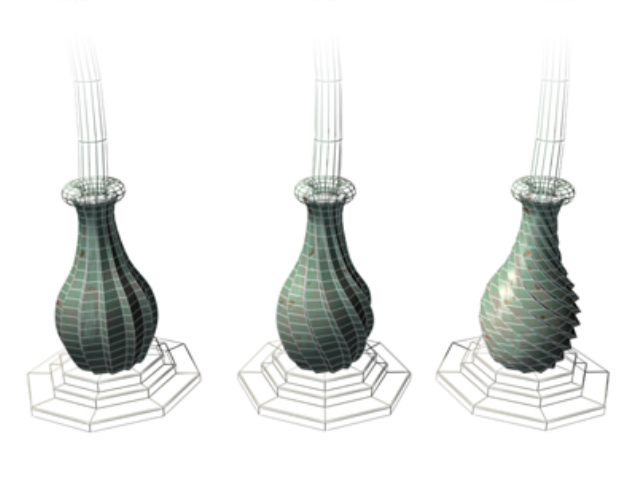
Modifiers
Modifiers provide a way for you to sculpt and edit objects. They can change the geometry of
an object, and its properties.
Example: effects of the Twist modifier on an object
The modifiers you apply to an object are stored in a stack on page 7850 . By navigating up and
down the stack, you can change the effect of the modifier, or remove it from the object. Or
you can choose to “collapse” the stack and make your changes permanent.
There are other general things to know about using modifiers:
■You can apply an unlimited number of modifiers to an object or part of an object.
9
1001
■When you delete a modifier, all its changes to the object disappear.
■You can move and copy modifiers to other objects using controls in the modifier stack
display on page 7427 .
■The order or sequence in which you add modifiers is important. Each modifier affects
those that come after it. For instance, adding a Bend modifier on page 1139 before a
Taper on page 1739 can give you distinctly different results than if you first added the
Taper followed by the Bend.
See also:
■List of Available Modifiers on page 1011
■Using the Modifier Stack on page 1020
■Modifier Stack Controls on page 7427
How Modifiers Differ from Transforms
Modifiers and transforms differ in how they affect an object and the order in which they
are applied to an object.
Transforms
The transform is the most basic of 3D manipulations. Unlike most modifiers, transforms
are independent of an object’s internal structure, and they always act in world space on
page 7976 . An object can carry any number of modifiers, but it always has only a single set
of transforms.
The transforms of an object are expressed as a matrix of values that contain the following
information:
■Position of the object center in world space
■Rotation of the object in world space
■Scale of the object along its local axes
The matrix is called the transformation matrix, and its information relates directly to the
transforms Move, Rotate, and Scale. Applying one of these transforms alters the values in
the transformation matrix.
Transforms have the following properties. They are:
■Applied to the entire object.
1002 | Chapter 9 Modifiers

■Independent of their order of application. No matter how many times you transform
an object, the results are stored as one set of values in the matrix.
■Applied after all object-space modifiers have been evaluated, but before the world-space
modifiers. See Using the Modifier Stack on page 1020 .
Most transforms produce equal displacement along one or more axes of an object, or part
of an object. For Move on page 888 , Rotate on page 889 , and Uniform Scale on page 892
transforms, the displacement is equal along all three axes. When you rotate a box, all sides
remain parallel. In general, all vertices keep the same relative position to one another. The
exceptions are Squash on page 894 and Non-Uniform Scale on page 893 , which displace
axes by different amounts.
TIP Use the XForm modifier on page 1922 if you want to transform an object at a specific location
in the stack (that is, after some object-space modifiers but before others), or if you want to
transform a sub-object selection. See Modifying at the Sub-Object Level on page 1029 .
Modifiers
Most modifiers allow you to perform operations on the internal structure of an object in
object space on page 7868 . For example, when you apply a modifier such as Twist on page
1765 to a mesh object, the position of each vertex of the object is changed in object space to
produce the twisting effect.
Modifiers can operate at the sub-object level, and are dependent on the internal structure
of the object when the modifier is applied.
Modifiers have the following properties. They are:
■Applied to all of an object or part of an object (using a sub-object selection).
■Dependent on the order of application. Applying a Bend followed by a Twist produces
a result different from applying a Twist followed by a Bend.
■Displayed as individual entries in the modifier stack, where you can turn them on or
off, and change the order in which they're applied.
Some modifiers operate in world space. These use world-space coordinates, and are applied
to the object after all object-space modifiers and transforms have been applied. Otherwise,
they have the same overall properties as object-space modifiers.
| 1003
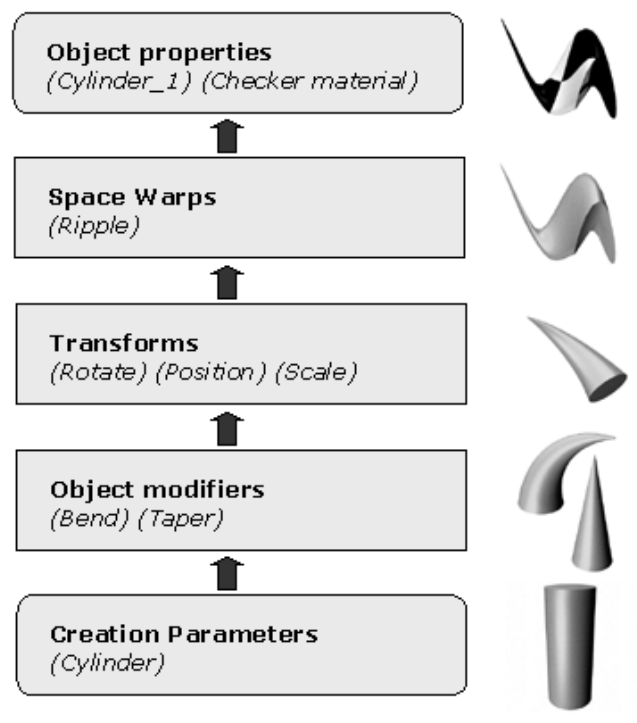
Transforms, Modifiers, and Object Data Flow
Once you have defined an object, 3ds Max evaluates changes affecting the
base object and displays the result in the scene. What these changes are, and
the order in which they are evaluated, is called the object data flow.
Diagram of data flow
1004 | Chapter 9 Modifiers
Master Object
Master object refers to an object defined by a set of creation parameters and
the original position and orientation of its pivot point. You never see the
master object. What you see in the viewport is always the result of at least the
following data flow:
Master Object
-> Object Transforms
-> Object Properties
Transforms, Modifiers, and Object Data Flow | 1005
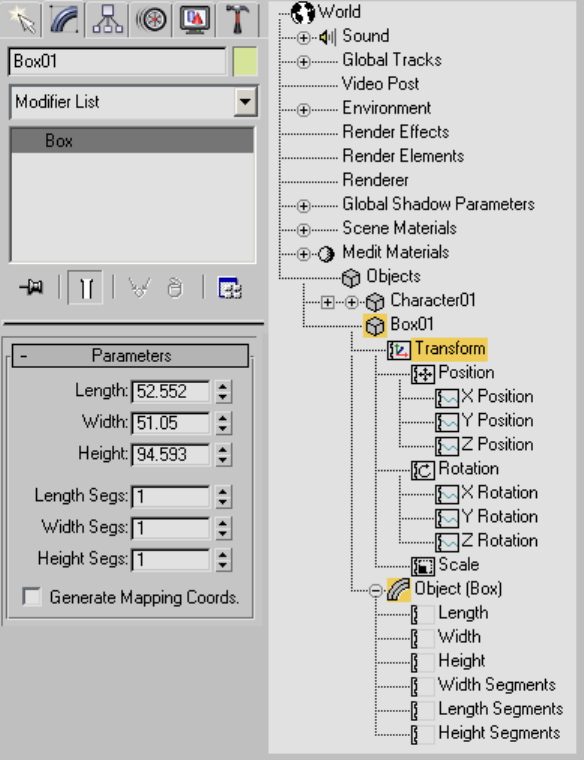
Object creation parameters in the Modify panel and Track View
1006 | Chapter 9 Modifiers
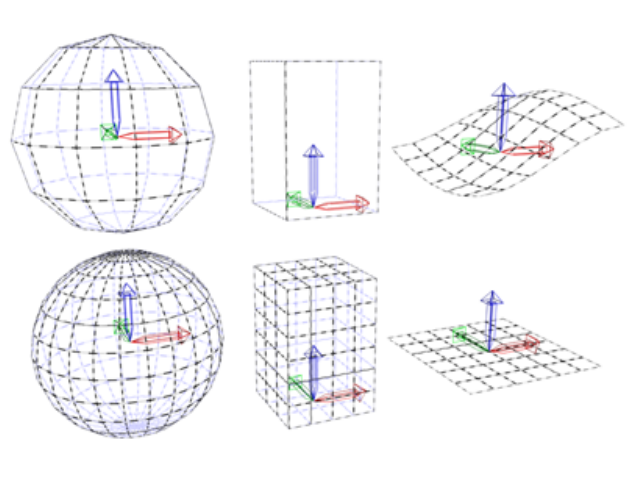
An example of master objects with different creation parameters.
Object-Space Modifiers
The object-space modifiers on page 1132 are the next group evaluated in the
data flow. Each modifier is evaluated in the order it was placed on the modifier
stack. The modifications all occur in the object’s object space and the result
is called the modified object.
Transforms, Modifiers, and Object Data Flow | 1007
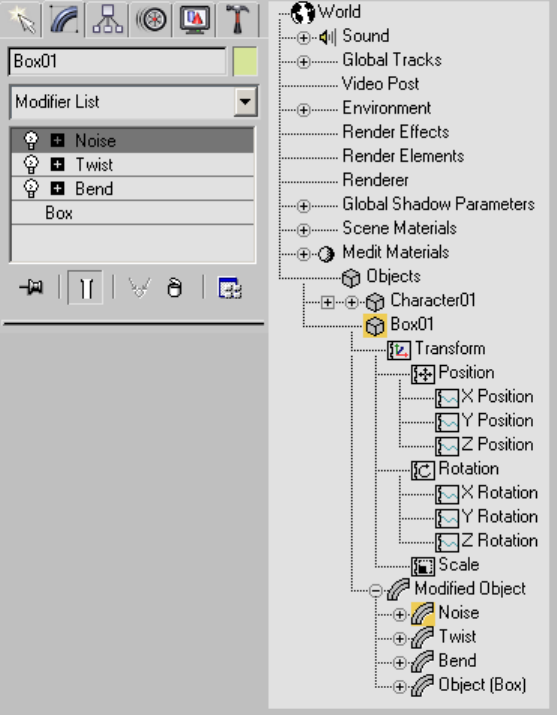
Object modifiers in the Modify panel and Track View
1008 | Chapter 9 Modifiers
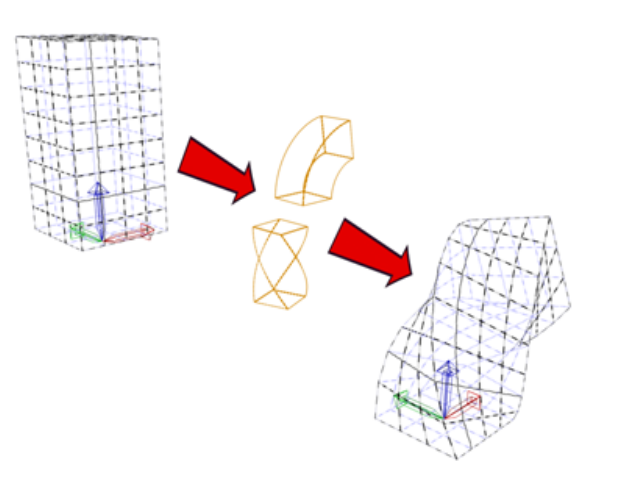
The effect of modifiers on a master object.
Object Transforms
Once the modified object has been evaluated, it is transformed within the
world coordinate system. Transforms cover the position, rotation, and scale
changes applied from the transform buttons on the toolbar .
The method of evaluating all modifiers first and then evaluating the combined
transforms has ramifications for the way you work with 3ds Max. The effect
of transforms is independent of the order in which they are applied. The order
in which you apply modifiers, on the other hand, does affect the resulting
geometry. If you want to apply a transform that is evaluated in a specific order
in the modifier stack, use the XForm modifier on page 1922 .
Transforms, Modifiers, and Object Data Flow | 1009
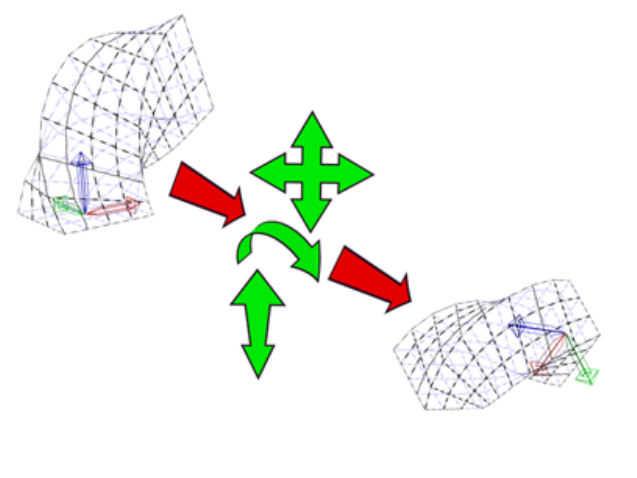
Transforming a modified object
Space Warps
Space warps on page 2603 are evaluated after transforms. They distort objects
bound to the space warp based on the position of the object in world space.
For example, a Wave space warp on page 2695 causes the surface of an object
to undulate in the form of a wave. As the object or the space warp moves
through world space, the waves move across the object’s surface.
Like space warps, world-space modifiers on page 1043 are evaluated after
transforms. A world-space modifier is like a space warp bound to a single
object.
Object Properties
Object properties are the last to be evaluated before the object is displayed.
These are values specific to an object such as its name or settings you specify
on the Object Properties dialog on page 245 , such as shadow-casting
properties; and materials you have applied to the object.
This is the end of the data flow, and the result is the named object you see in
your scene.
1010 | Chapter 9 Modifiers
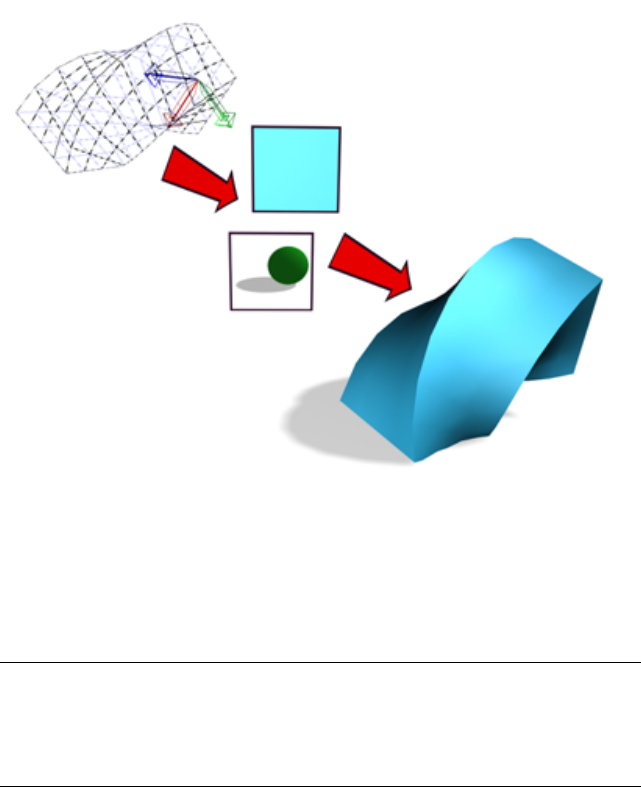
Right-click an object and choose Properties to display its Object Properties
dialog.
Object Properties affect the look of an object's rendered output.
List of Available Modifiers
Following is a list of the modifiers, listed in alphabetical order.
NOTE The availability of certain modifiers depends on the current selection. For
example, Bevel and Bevel Profile appear in the Modifier List drop-down menu only
when a shape or spline object is selected. For the conditions under which a specific
modifier is available, see the path annotation at the top of the modifier's topic in
this reference.
Affect Region Modifier on page 1133
Attribute Holder Modifier on page 1136
Bend Modifier on page 1139
Bevel Modifier on page 1142
List of Available Modifiers | 1011
Bevel Profile Modifier on page 1150
Camera Map Modifier (Object Space) on page 1154
Camera Map Modifier (World Space) on page 1043
Cap Holes Modifier on page 1159
Cloth Modifier on page 1178
CrossSection Modifier on page 1259
Delete Mesh Modifier on page 1266
Delete Patch Modifier on page 1267
Delete Spline Modifier on page 1269
Disp Approx Modifier on page 1270
Displace Modifier on page 1274
Displace Mesh Modifier (World Space) on page 1045
Displace NURBS Modifier (World Space) on page 1047
Edit Mesh Modifier on page 1283
Edit Normals Modifier on page 1284
Edit Patch Modifier on page 1290
Edit Poly Modifier on page 1293
Edit Spline Modifier on page 1376
Extrude Modifier on page 1377
Face Extrude Modifier on page 1381
FFD (Free-Form Deformation) Modifiers on page 1383
FFD (Free-Form Deformation) (Box/Cyl) Modifier on page 1389
FFD (Free-Form Deformation) Select Modifier on page 1395
Fillet/Chamfer Modifier on page 1396
Flex Modifier on page 1400
Garment Maker Modifier on page 1228
Hair And Fur Modifier on page 1049
HSDS Modifier on page 1420
Lathe Modifier on page 1430
1012 | Chapter 9 Modifiers
Lattice Modifier on page 1435
Linked XForm Modifier on page 1440
LS Colors Modifier (World Space) on page 1118
LS Mesh Modifier on page 1442
MapScaler Modifier (Object Space) on page 1443
MapScaler Modifier (World Space) on page 1120
Material Modifier on page 1445
MaterialByElement Modifier on page 1448
Melt Modifier on page 1451
Mesh Select Modifier on page 1455
MeshSmooth Modifier on page 1460
Mirror Modifier on page 1471
Morpher Modifier on page 1473
MultiRes Modifier on page 1493
Noise Modifier on page 1501
Normal Modifier on page 1509
NSurf Sel Modifier on page 1513
Normalize Spline Modifier on page 1511
Optimize Modifier on page 1515
PatchDeform Modifier (World Space) on page 1123
PathDeform Modifier (World Space) on page 1123
PatchDeform Modifier on page 1525
Patch Select Modifier on page 1520
PathDeform Modifier on page 1528
Physique Modifier on page 4589
Point Cache Modifier on page 1533
Point Cache Modifier (World Space) on page 1129
Poly Select Modifier on page 1541
Preserve Modifier on page 1550
List of Available Modifiers | 1013
Projection Modifier on page 1556
Projection Holder Modifier on page 1574
Push Modifier on page 1574
Relax Modifier on page 1575
Renderable Spline Modifier on page 1580
Ripple Modifier on page 1583
Select By Channel Modifier on page 1587
Shell Modifier on page 1588
Skew Modifier on page 1596
Skin Modifier on page 1600
Skin Morph Modifier on page 1636
Skin Wrap Modifier on page 1648
Skin Wrap Patch Modifier on page 1657
Slice Modifier on page 1658
Smooth Modifier on page 1665
Spherify Modifier on page 1668
Spline IK Control Modifier on page 1670
Spline Select Modifier on page 1673
Squeeze Modifier on page 1676
STL Check Modifier on page 1678
Stretch Modifier on page 1681
Subdivide Modifier on page 1688
Substitute Modifier on page 1691
Surface Mapper Modifier (World Space) on page 1129
Surface Modifier on page 1695
SurfDeform Modifier on page 1707
SurfDeform Modifier (World Space) on page 1132
Sweep Modifier on page 1709
Symmetry Modifier on page 1735
1014 | Chapter 9 Modifiers
Taper Modifier on page 1739
Tessellate Modifier on page 1743
Trim/Extend Modifier on page 1746
TurboSmooth Modifier on page 1750
Turn To Mesh Modifier on page 1756
Turn To Patch Modifier on page 1758
Turn To Poly Modifier on page 1761
Twist Modifier on page 1765
Unwrap UVW Modifier on page 1769
UVW Map Modifier on page 1849
UVW Mapping Add Modifier on page 1871
UVW Mapping Clear Modifier on page 1871
UVW XForm Modifier on page 1872
VertexPaint Modifier on page 1876
Vertex Weld Modifier on page 1874
Volume Select Modifier on page 1910
Wave Modifier on page 1918
XForm Modifier on page 1922
Using Modifiers
This section contains a number of topics intended to help you learn how to
use modifiers and the Modify panel. These include:
Using the Modify Panel on page 1016
Using the Modifier Stack on page 1020
Editing the Stack on page 1023
Edit Modifiers and Editable Objects on page 1027
Modifying at the Sub-Object Level on page 1029
Using the Stack at the Sub-Object Level on page 1032
Using Modifiers | 1015

Modifying Multiple Objects on page 1034
How Instanced Modifiers Work on page 1040
Using the Modify Panel
After adding objects to your scene from the Create panel, you often move to
the Modify panel to change an object’s original creation parameters and to
apply modifiers. Modifiers are the basic tools for reshaping and adjusting
primitive geometry.
NOTE You can float on page 7761 or dismiss the command panel using the
Customize Display right-click menu on page 7479 . The default setting is to display
the command panel docked at the right of your screen. If it is not displayed or
you want to change its location and docking or floating status, right-click in a
blank area on any toolbar, and choose from the shortcut menu.
The Modify panel stays in view until you click another command panel tab.
The panel updates to show the options and controls that are available for the
currently selected object or modifier.
Using Modifiers
Once you’ve applied modifiers to an object, you can use the Modifier Stack
on page 7427 to find a particular modifier, change its parameters, edit its
sequence in the modifier stack, copy its settings to another object, or delete
it entirely.
You can find a complete, alphabetical list of modifiers in List of Available
Modifiers on page 1011 .
General Guidelines
You can generally do the following with the Modify panel:
■Modify anything you can select. This includes any object or set of objects,
or any part of an object down to the sub-object level. For example, you
can use the Mesh Select modifier to select a single face, then apply a Taper
modifier to it.
■Apply an unlimited number of modifiers to an object or part of an object.
The order or sequence in which you make modifications is important.
Each modification affects those that come after it. See Using the Modifier
Stack on page 1020 .
1016 | Chapter 9 Modifiers
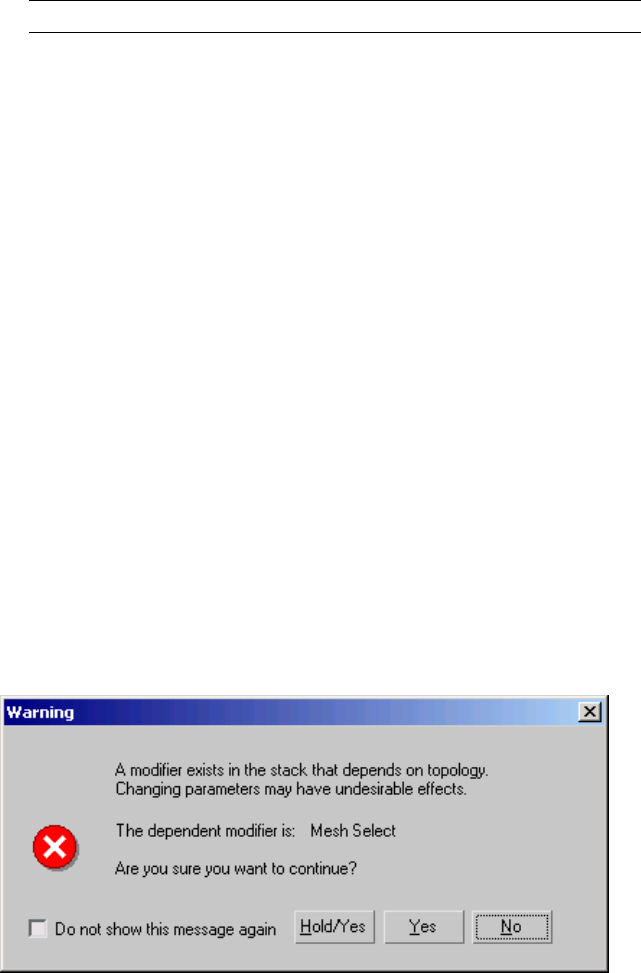
NOTE Some modifiers can be applied only to certain types of objects.
Modifier Sub-Object Levels
In addition to its own set of parameters, a modifier typically has one or more
sub-object levels that you access through the modifier stack on page 1020 . The
most common of these are a gizmo and a center.
Gizmo Displays in viewports as a wireframe that initially surrounds the
selected object. A gizmo acts like a mechanical apparatus that transfers its
modification to the object it’s attached to. To alter the effect of the modifier
on the object, you can move, scale, and rotate the gizmo as you would any
object.
Center The center is the modifier's pivot point on page 7895 . You can move
a modifier’s center, which alters the effect of the modifier on the object.
Parametric Deformations and Other Modifier Types
One set of object-space modifiers is known as parametric deformations
(“parametric deforms” on the Modifiers menu). Twist on page 1765 and Bend
on page 1139 are examples. Parametric deformations alter the selection passed
to them without explicitly depending on topology.
Many other types of modifiers, however, perform operations on the explicit
topology of sub-object selections. The Edit modifiers and Select modifiers are
examples. When a topology-dependent modifier is present on the stack, you
can adversely affect its results if you visit previous stack operations and change
the number or order of sub-objects (such as faces or vertices) in the selection.
If you try to do this, a warning alerts you to the situation.
Using the Modify Panel | 1017

You can safely edit the stack beneath the topology-dependent modifier, as
long as you do not add or remove sub-objects from the selection on which it
operates.
Procedures
To use the Modify panel:
1Select an object in your scene.
2 Click the Modify tab to display the Modify panel.
The name of the selected object appears at the top of the Modify panel,
and fields change to match this object.
The objects creation parameters appear in rollouts on the Modify panel,
below the modifier stack display. You can use these rollouts to change
the creation parameters for an object. As you change them, the object
updates in the viewports.
3Apply a modifier to an object (described in the next procedure).
After you apply a modifier, it becomes active, and rollouts below the
modifier stack display settings specific to the active modifier.
To apply a modifier to an object:
1Select the object.
2Do one of the following:
■Choose a modifier from the Modifier List. This is a drop-down list at
the top of the Modify panel.
1018 | Chapter 9 Modifiers
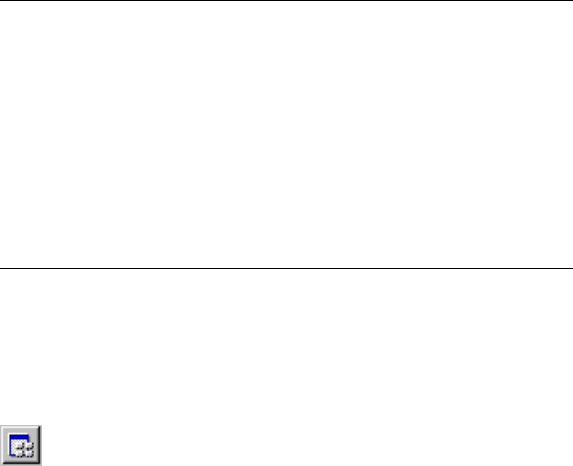
TIP You can use the mouse or keyboard to choose a modifier from the
Modifier List. To use the keyboard, first open the list with the mouse, and
then type the first letter in the modifier's name. From there you can use
the arrow keys or the method described in the following paragraph to
highlight the desired modifier, and then press Enter to assign the modifier.
In many cases, several modifier names start with the same letter. You
can go directly to a particular modifier if you type the first few letters
(enough for a unique combination) in the desired modifier's name
quickly. For example, say you want to assign the Mirror modifier to
an object. Typing M goes to Mesh Select, which isn't anywhere near
Mirror in the Modifier list, but typing MI goes directly to Mirror.
■Choose a modifier from the Modifiers menu. This menu is organized
into sets by functionality.
Not all modifiers appear on the Modifiers menu.
■If the modifier buttons are visible on the Modify panel and the
modifier you want is one of them, click the button.
If the buttons are not visible but you want to use them, click
the Configure Modifier Sets button on page 7450 (below the modifier
stack display) and choose Show Buttons. A set of buttons with the
names of modifiers appears between the modifier list and the stack
display. Click Configure Modifier Sets again, choose the set of
modifiers you want to use (for example, Free-Form Deformations),
and then click the button for the modifier you want to apply.
Rollouts are now displayed below the modifier stack display, showing
settings for the modifier. As you change these settings, the object updates
in viewports.
To drag a modifier to an object:
1Select an object that already has a modifier you would like to use on
another object.
2To copy the modifier without instancing it, drag the modifier's name
from the stack display to the object in a viewport that you want to use
the same modifier. To move the modifier, use Shift+drag; this removes it
from the original object and applying it to the new one. To instance the
modifier, use Ctrl+drag; this creates an instanced modifier applied to both
the original object and the new one.
Using the Modify Panel | 1019

NOTE Instancing a modifier causes its name to be displayed in italics in the
modifier stack. This indicates that the modifier is instanced, meaning that a
change to the modifier parameters of one object will affect the other.
Using the Modifier Stack
The modifier stack and its editing dialog are the keys to managing all aspects
of modification. You use these tools to:
■Find a particular modifier and adjust its parameters.
■View and manipulate the sequence of modifiers.
■Copy, cut, and paste modifiers between objects, or sets of objects.
■Deactivate the effect of a modifier in the stack, the viewport display, or
both.
■Select a modifier’s components, such as gizmo or center.
■Delete modifiers.
See also:
■Editing the Stack on page 1023
■Modifier Stack Controls on page 7427
■Modifier Stack Right-Click Menu on page 7440
Examining the Modifier Stack
The modifier stack (or "stack" for short) is a list on the Modify panel. It contains
the accumulated history of a selected object and any modifiers you have
applied to it.
Internally, the software "evaluates" an object beginning at the bottom of the
stack and applies changes to the object by moving sequentially to the top of
the stack. You should therefore "read" the stack from bottom up to follow the
sequence used by the software in displaying or rendering the final object.
Here is an example of stack entries for a capsule object (an extended primitive):
1020 | Chapter 9 Modifiers
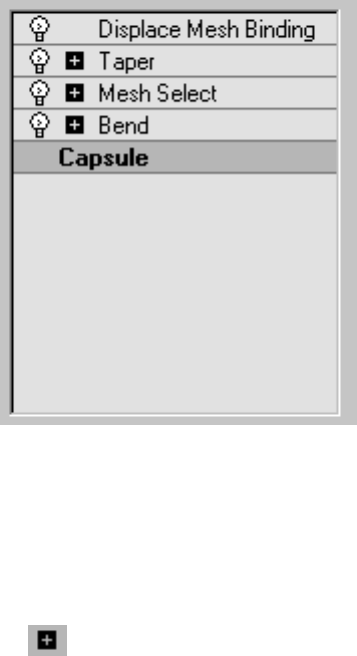
■At the bottom of the stack, the first entry always lists the object type (in
this case, Capsule). You click this entry to display the original object
creation parameters so you can adjust them. If you haven’t applied any
modifiers yet, this is the only entry in the stack.
■Object-space modifiers appear above the object type. You click a modifier
entry to display the modifier’s parameters so you can adjust them, or to
delete the modifier.
Modifiers are preceded by a plus or minus icon if they have sub-object
(or sub-modifier) levels. See Using the Stack at Sub-Object Level on page
1032 .
■At the top of the stack are world-space modifiers and space warps bound
to the object. (In the illustration, Displace Mesh is a world-space modifier.)
These always appear at the top, and are described as "bindings."
Basics of Using the Stack
With the stack feature, no modification has to be permanent. By clicking an
entry in the stack, you can go back to the point where you made that
modification. You can then rework your decisions, temporarily turn off the
modifier, or discard the modifier entirely by deleting it. You can also insert a
new modifier in the stack at that point. The changes you make ripple upward
through the stack, changing the current state of the object.
Using the Modifier Stack | 1021
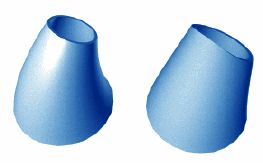
Adding Multiple Modifiers
You can apply any number of modifiers to an object, including repeated
applications of the same modifier. As you start applying object modifiers to
an object, the modifiers "stack up" in the order they’re applied. The first
modifier appears just above the object type at the bottom of the stack.
■The program inserts a new modifier in the stack just above the current
selection, but always in the proper location. If you try to insert a
world-space modifier between two object-space modifiers, the program
automatically places it at the top of the stack.
■If you select the object type on the stack and apply a new object-space
modifier, it appears just above the object type and becomes the first
modifier evaluated.
Effect of Stack Sequence
The software applies modifiers in their stack order (beginning at the bottom
and carrying the cumulative change upward), so a modifier's location in the
stack can be critical.
The following figure shows the difference between the objects based entirely
on a reversal in the stack order of two modifiers. On the left-hand tube, a
Taper modifier is applied before a Bend modifier, and on the right-hand tube,
the Bend is applied first.
Results of reversing stack order of two modifiers
Using the Buttons
The Modifier Stack rollout has the following buttons to help you manage the
stack:
1022 | Chapter 9 Modifiers

Pin Stack Locks the stack and all Modify panel controls to the selected
object’s stack. You can continue to edit the object even if you select a different
object in the viewports.
Show End Result When on, shows the effect of the entire stack on the
selected object. When off, shows the effect of the stack only up to the currently
highlighted modifier.
Make Unique Makes an instanced object unique, or an instanced
modifier unique to a selected object. See details in Editing the Stack on page
1023 . This option is also available from the Modifier Stack right-click menu on
page 7440 .
Remove Modifier Deletes the current modifier from the stack,
eliminating all changes caused by that modifier.
Configure Modifier Sets Click to display a pop-up menu that lets you
configure how to display and choose modifiers on the Modify panel.
Editing the Stack
You can copy, cut, and paste modifiers within an object’s stack, or into the
stacks of other objects. Among other features, you can give modifiers explicit
names to help you remember the intended effect.
To edit the stack:
1Choose an item in the stack.
2Right-click.
This displays the Modifier Stack right-click menu on page 7440 , which is
briefly introduced in this topic.
Editing the Stack | 1023

Rearranging and Sharing Modifiers
To rearrange modifiers:
The easiest way to move a modifier to a different location in the stack is simply
to drag it there. Alternatively, you can use the following cut/copy and paste
procedure.
1Choose one or more modifiers, right-click, and choose Copy or Cut.
2Choose a new location in the list, right-click, and choose Paste. The paste
occurs immediately above the new location.
To share modifiers with other objects:
1Choose one or more modifiers, right-click, and choose Copy.
2Select a different object or group of objects.
3Choose a location in the new stack, right-click, and choose Paste.
You can also drag from the modifier stack display to an object in a
viewport.
TIP Select world-space and object-space modifiers separately. Cut, Copy,
and Paste are disabled if both types are selected. If you try to paste a
world-space modifier into the section for object-space types, the paste occurs
at the top of the world-space section. The reverse is also true.
Unique and Instanced Modifiers
By default, pasted modifiers are unique: they lose all connection with the
modifier from which they were copied. Compare with an instanced modifier,
which is shared between two or more objects. Changing a parameter on an
instanced modifier automatically changes the same parameter on the other
instanced objects.
To create an instance of a modifier:
■After copying or cutting the modifier, right-click and choose Paste
Instanced.
In the stack, the name of an instanced modifier appears in italics.
Any instance of a modifier controls all other instances. Use this feature when
you want a number of objects to take on the same feature.
1024 | Chapter 9 Modifiers

For example, copying an instanced Bend modifier on page 1139 to a number
of trees would make them all bend identically. Changing Bend parameters on
any one tree would change the bend on all the others.
To remove the instancing from a modifier:
■ Select the instanced modifier and click Make Unique. This converts
the modifier from instanced to unique.
Using Make Unique with Multiple Items
Assume you have a group of trees all sharing the same instanced Bend modifier.
If you select two of them and click Make Unique on page 7446 , a message asks,
"Do you want to make the selected objects unique with respect to each other?"
■If you click Yes, the two trees become independent of one another. Each
has a unique copy of the modifier and can be bent separately.
■If you click No, the two trees continue to share the same instanced modifier,
but separately from the instance in the original group. The two trees can
be bent together.
See How Instanced Modifiers Work on page 1040 .
Collapsing the Stack
You can use Collapse All or Collapse To to collapse all or part, respectively,
of an object's stack to an editable object that preserves the cumulative effect
of the collapsed modifiers on the base object. You might choose to do this in
these cases:
■You’ve finished modifying an object and want to keep it as is.
■You want to discard an object's animation tracks. Alternatively, you can
Alt+right-click a selected object and choose Delete Selected Animation.
■You want to simplify a scene and save some memory.
NOTE In most cases, collapsing all or part of the stack will save memory. However,
collapsing some modifiers, such as Bevel, increases file size and memory use.
After you collapse an object’s stack, you can no longer parametrically adjust
either its creation parameters or the individual modifiers affected by the
Editing the Stack | 1025

collapse. Animation tracks that were assigned to such parameters also
disappear.
Collapsing the stack does not affect the object’s transforms; it affects
world-space bindings only if you use Collapse To. Collapsing the stack does
not save memory if the stack contains no modifiers.
TIP Before you use either Collapse option, use File menu > Save Selected to
preserve a copy of the original parametric object.
To collapse the stack:
1Right-click the modifier stack display.
2If modifiers have been applied to the object, choose Collapse To or
Collapse All.
Collapse To Collapses the stack, up to and including the chosen
modifier, into an editable object. Modifiers on the stack above the chosen
modifier are not affected, and you can still adjust them individually.
The resultant object type depends on the uppermost modifier that outputs
a specific geometry type, if any. If the stack contains no such modifier,
the result is an editable mesh on page 1990 . If the collapsed portion of
the stack contains a modifier that outputs a specific geometry type, and
no other such modifier is above it, the result is that type of object. For
example, if the topmost such collapsed modifier is Edit Poly, the resultant
object is Editable Poly.
Collapse All Collapses the entire stack into an editable object, other
than world-space bindings. Any world-space bindings on the stack are
left intact.
The resulting stack list shows a single entry: Editable Mesh, unless any
modifiers on the stack output a different type of geometry. For example,
if the topmost such modifier is Edit Poly, the resultant object is Editable
Poly.
If no modifiers are applied to the object, choose one of the Convert To
options:
■Editable Mesh
■Editable Spline
■Editable Patch
■Editable Poly
■NURBS
1026 | Chapter 9 Modifiers
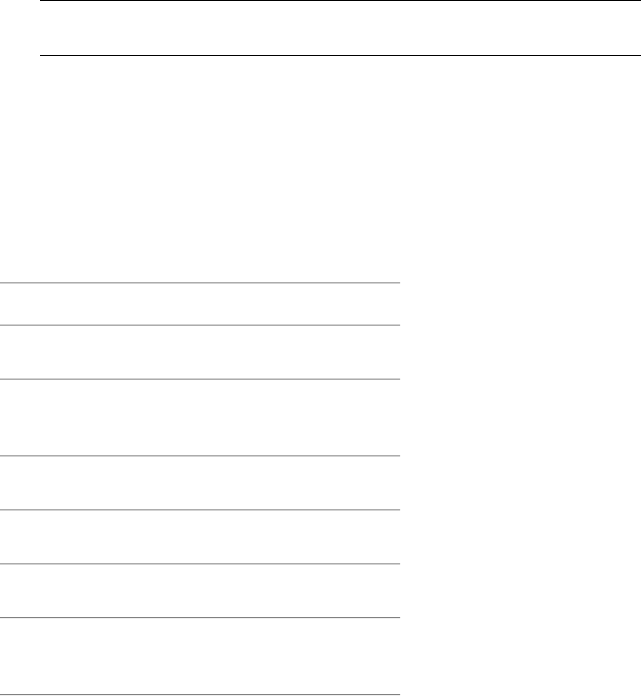
NOTE Depending on the object type, not all Convert To options might be
available.
Edit Modifiers and Editable Objects
To achieve highly detailed modeling effects, you can directly transform,
modify, and align the geometry of objects at a sub-object level on page 7940 ,
using the Modify panel on page 7425 . The following table shows the different
object types and their respective sub-objects.
Sub-Object GeometryObject Type
Vertex, Edge, Face, Polygon, ElementMesh
Vertex, Edge, Border, Polygon, Ele-
ment
Poly
Vertex, Segment, SplineSpline
Vertex, Edge, Patch, Element, HandlePatch Surface
Curve CV or Point, CurveNURBS Curve
Surface CV or Point, SurfaceNURBS Sur-
face
With the exception of NURBS, to gain access to an object's sub-objects, in
most cases you must first either convert the object into an editable object, or
apply any of various modifiers to the object, such as Edit Mesh/Spline/Patch
or Mesh/Spline Select. The Select modifiers simply let you specify sub-objects
for modification by subsequently applied modifiers. The distinctions between
Edit Modifiers and Editable Objects | 1027
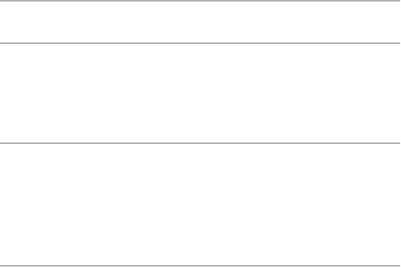
transforming an object into an editable object and applying an Edit modifier
to it are as follows:
DisadvantageAdvantageMethod
Lose creation
parameters
More efficient
Can animate
sub-objects
Editable object
Less efficient
Cannot ani-
mate sub-ob-
jects
Keep creation
parameters
Edit/Select mod-
ifier
To convert a parametric object to an editable object, see any of the following
topics:
Editable Mesh Surface on page 1990
Editable Poly Surface on page 2038
Editable Spline on page 590
Editable Patch Surface on page 1934
To apply an Edit modifier, see any of the following topics:
Edit Mesh Modifier on page 1283
Edit Spline Modifier on page 1376
Edit Patch Modifier on page 1290
To apply a Select modifier, see the following topics:
Mesh Select Modifier on page 1455
Poly Select Modifier on page 1541
Spline Select Modifier on page 1673
Volume Select Modifier on page 1910
Patch Select Modifier on page 1520
1028 | Chapter 9 Modifiers
Modifying at the Sub-Object Level
To achieve highly detailed modeling effects, you can directly transform,
modify, and align the geometry of objects at the sub-object level on page 7940
.
Sub-objects are the pieces that make up objects, such as vertices and faces.
You can also access and transform the sub-object components of modifiers.
The particular geometry available at sub-object level depends on the object
type. See Edit Modifiers and Editable Objects on page 1027 for details on each
object type.
Modifying at the Sub-Object Level | 1029
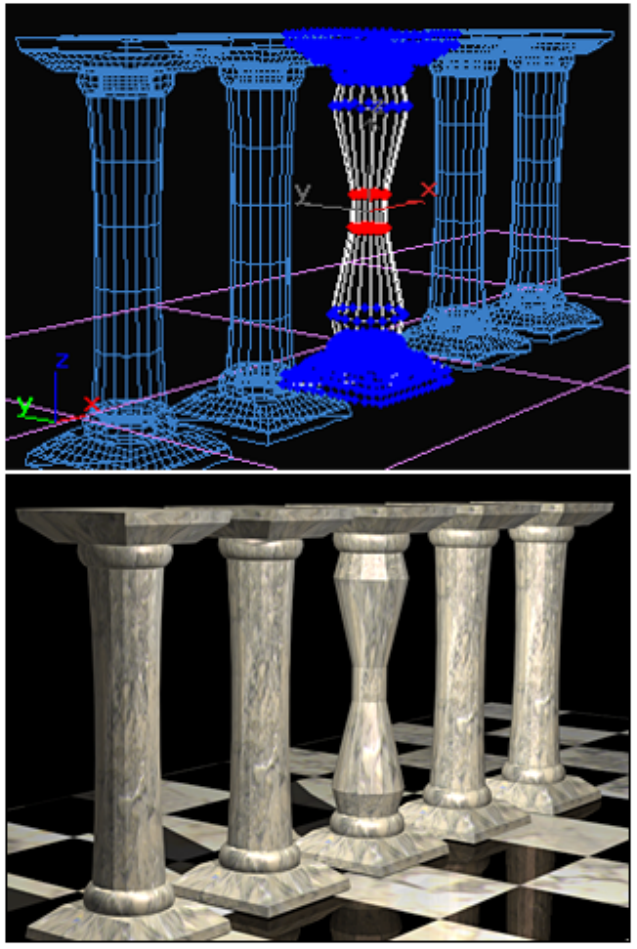
In a row of column sub-objects, a single column has been modified at the sub-object
level.
1030 | Chapter 9 Modifiers

Making a Sub-Object Selection
These are the general steps in setting up an object for sub-object selection. See
Edit Modifiers and Editable Objects on page 1027 for more information.
1Convert the object into an editable object such as an editable mesh,
editable spline, editable poly, and so on. (Some modifiers you can apply
to the object, such as Edit Mesh, Mesh Select or Spline Select, also have
sub-object levels.)
TIP Work in a wireframe viewport so you can see the geometry.
2 On the modifier stack display, click the plus icon to the left of the
name of the modifier or editable object. This expands the object's
hierarchy, showing the names of the sub-object levels at which you can
work.
3On the stack display, choose the kind of sub-object geometry you want
to work with: for example, Vertex, Face, or Edge. Each sub-object selection
level has rollouts with their own sets of options.
The sub-object level highlight is yellow by default.
4Use standard selection techniques to select sub-object geometry, from a
single sub-object to the entire object. By default, the sub-object selection
highlights in red.
Once you make a sub-object selection of geometry, you can do any of the
following:
■Apply any options supplied for the kind of object and the selection level.
■Apply standard transforms: Move, Rotate, Scale. For more information, see
Transforming a Sub-Object Selection, following.
■Apply object-space modifiers (Bend, Taper, and Twist, for example) to
perform useful modeling operations.
■Apply object-space modifiers (UVW Map or Smooth, for example) to
perform useful surfacing operations.
■Bind a space warp on page 2603 to the selection. The rest of the object is
unaffected by the warping.
■Use the toolbar commands Align on page 938 , Normal Align on page 945
, and Align To View on page 951 with face selections.
Modifying at the Sub-Object Level | 1031
Transforming a Sub-Object Selection
Using an editable mesh, poly, patch, or spline, you can directly transform any
sub-object selection. However, “Select” modifiers like Mesh Select on page
1455 and Spline Select on page 1673 enable only selection.
To transform a sub-object selection made with a Select modifier:
1Add an XForm modifier on page 1922 to the stack, following (or somewhere
above) the Select modifier.
2In the stack, open the Select modifier and make a sub-object selection.
3Choose XForm in the stack. You then transform the XForm gizmo, which
applies the transform to the selection.
Selecting and Transforming Modifier Components
Most modifiers have sub-object components, such as a gizmo and center. Like
sub-object geometry, these components can be accessed and transformed at
sub-object level, directly modifying the object’s shape.
Other modifiers, like those for free-form deformation, have control points
and lattices at a sub-object level. Moving these components creates the
modeling effects of the modifier.
Using the Stack at the Sub-Object Level
With editable objects such as meshes and splines, or modifiers with sub-object
levels such as Mesh Select and Spline Select, you can continue to model a
single sub-object selection by applying any number of other modifiers. When
you go back and change the original selection, the new selection is "passed
up the stack" to the modifiers that follow.
Editable meshes and splines have "built-in" sub-object selection at their base
level. But the selections you make with Mesh Select and Spline Select work
exactly the same way on the stack.
This topic uses meshes for its examples. You can apply the same concepts to
editable splines, patches, and poly objects.
1032 | Chapter 9 Modifiers
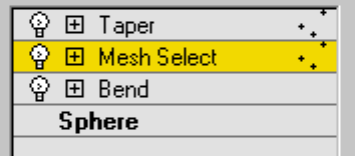
Working at Two Levels
When you select an object and apply modifiers (for example, Bend and Taper),
you’re working with the object as a single unit, or "whole object", at the object
level.
When you make a sub-object selection, the stack display changes to show you
are no longer working with the whole object. Consider the effect of a Mesh
Select applied between Bend and Taper modifiers (Bend is below Taper). To
the right of the Mesh Select and Taper modifiers, a sub-object icon (similar to
the sub-object button in the Selection rollout) appears to show that sub-object
selection is now in effect.
The vertex sub-object selection made at the Mesh Select level is passed up the
stack to the Taper modifier. This means the Taper modifier is applied only to
the vertices selected at the Mesh Select level.
Sub-object icon (in this case, for Vertex) to the right of modifier names in the stack
display
Sub-object selection carries upward through the stack. If you add more
modifiers, each shows the sub-object icon to indicate this state.
By learning to "read the stack," you can move back and forth between the
object and sub-object levels while you work on an object.
Returning to Whole-Object Level
When you finish modeling a certain sub-object selection, you can return to
work on the whole object.
To return the stack to object level:
1At any point in the stack, apply another Mesh Select modifier.
2Leave this Mesh Select modifier at the top level (the object level, which
highlights in gray). Any modifiers already on the stack above this modifier
no longer show the sub-object icon. Any modifiers you add above the
second Mesh Select now apply to the whole object.
Using the Stack at the Sub-Object Level | 1033
3To continue sending the sub-object selection up the stack, delete the
second Mesh Select.
Naming Sub-Object Selections
Sub-object selections are often quite complex, involving a great many small
elements that would be difficult to select a second time. For this reason, it’s
a good idea to name important selection sets using the Named Selection Sets
list on page 146 on the Main toolbar.
Named sub-object selections only appear at the type of level where they were
first named. For example, if you select a set of vertices, you can name the
selection at that vertex sub-object level. Then, when you later go to retrieve
the named selection, you can access it only from the same modifier's vertex
sub-object level.
Copying Sub-Object Selections
Once you name a sub-object selection set, you can copy it between modifiers
in the same stack, or to the stack of another object of the same type. Editable
meshes and Mesh Select (and their spline , patch, and poly counterparts) have
buttons for Copy and Paste at each level of geometry, in the Modify panel >
Selection rollout.
To copy/paste named sub-object selections:
1Make a sub-object selection.
2In the Selection rollout, click Copy. From the dialog, choose any available
named selection set for that level of geometry.
3Go to another Select modifier or to an editable mesh or poly, at the same
level of geometry. Click Paste to complete the copy.
Modifying Multiple Objects
You can apply modifiers to multiple objects. In general, the process is parallel
to modifying a single object. You make a selection set and apply an available
modifier. The modifier then appears on a special stack that refers only to the
commonality of that selection set.
1034 | Chapter 9 Modifiers
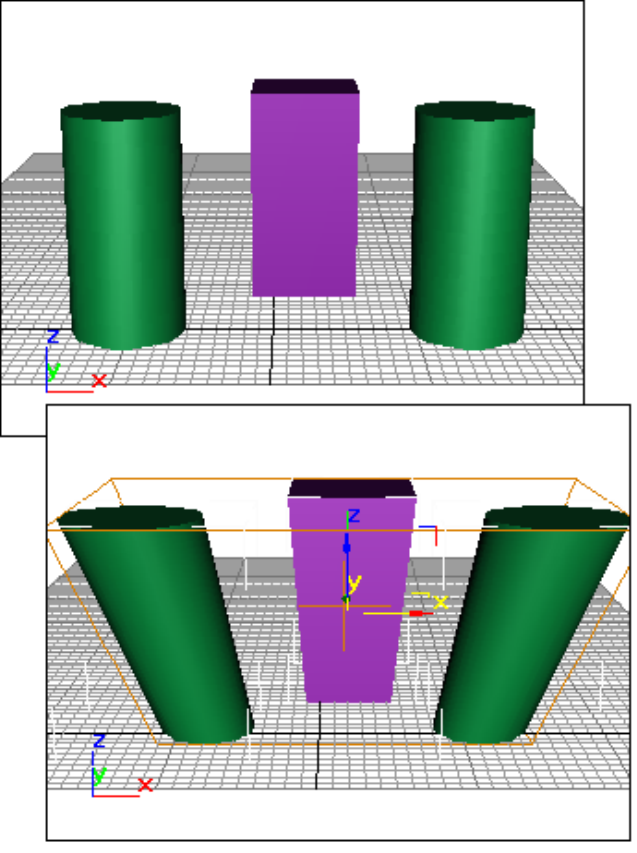
Top: Original objects
Bottom: Single modifier applied to objects
Modifying Multiple Objects | 1035

The Principle of Commonality
When you select multiple objects, 3ds Max determines what the particular
selected set of geometry has in common, if anything. Given any "commonality"
among objects, 3ds Max presents the options as available modifiers.
Unavailable modifiers represent areas where commonality does not hold.
You can apply modifiers to different categories of objects, depending on the
modifier. For example, you might apply Bend to both a 3D object and a 2D
shape. You can apply Mesh Select to a spline primitive and convert it to a
mesh, but the reverse is not true: Spline Select is restricted to objects of the
spline category.
To modify multiple objects:
1Select two or more objects.
For selection sets, the name at the top of the Modify panel changes to
read "Multiple Selected." If the objects are grouped, the group name
appears.
2Choose the kind of pivot point you want to use. See Using Pivot Points,
(below).
3Apply a modifier and adjust its parameters.
If you apply a Mesh Select modifier, you can select geometry on one or
more of the objects to use as a sub-object selection set.
Using Pivot Points
The first item in the Modifier List is a toggle called Use Pivot Points. This
toggle is available only when multiple objects are selected.
■When on, the program uses the pivot point of each object as the center
of a modifier’s operation. For example, if you bend a line of trees around
the Z axis, each bends along its own trunk.
■When off, the program calculates a central pivot point for the entire
selection set, and modifies the selection as a whole. For a Z-axis bend, trees
at the end of a line would deform more than those at the center where the
pivot is located.
IMPORTANT Choose the pivot setting before you apply the modifier. You
can’t change the pivot point afterward, although you can delete the modifier
and start over without deselecting the selection set.
1036 | Chapter 9 Modifiers
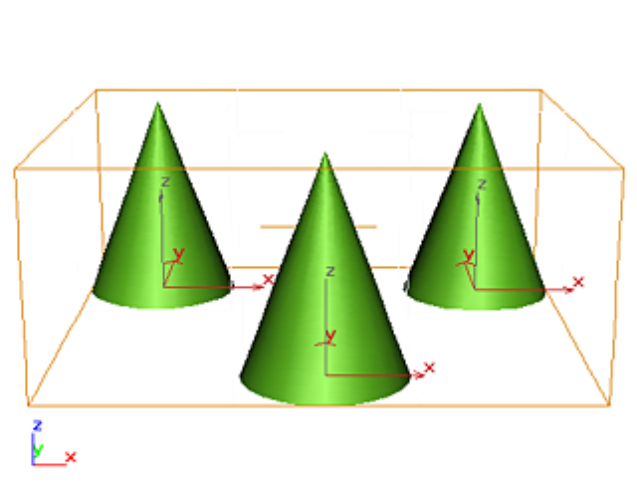
Original objects
Modifying Multiple Objects | 1037
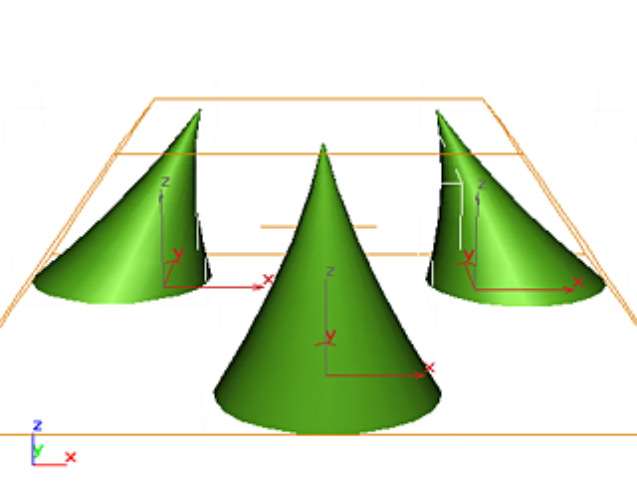
Single modifier applied to all objects
1038 | Chapter 9 Modifiers
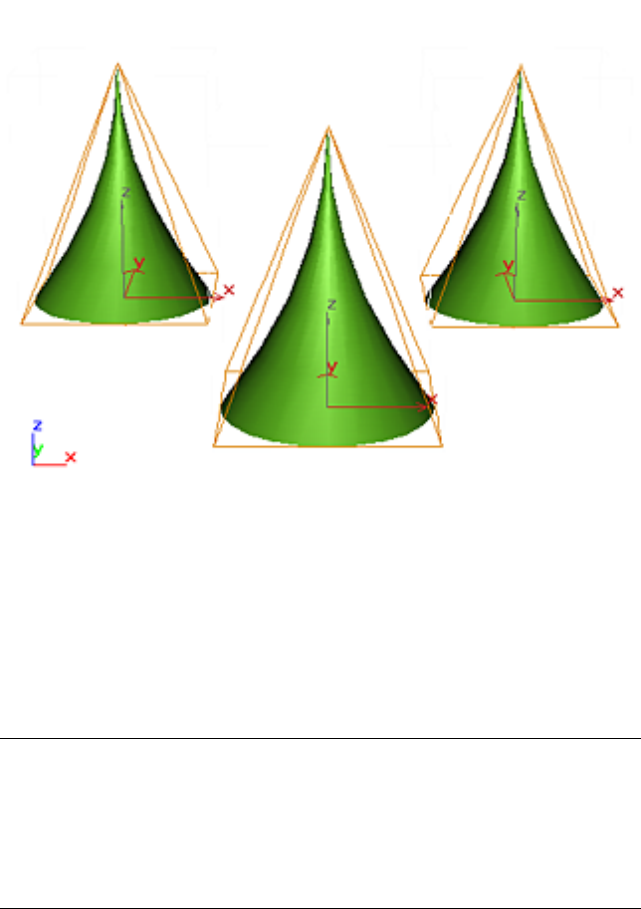
Single modifier applied with Use Pivot Points activated
Instanced Modifiers
When you apply a modifier to multiple objects, each object receives an
identical version of the modifier. These are called instanced modifiers. They
are interchangeable. A change to any one of the instances affects all the other
instances. How Instanced Modifiers Work on page 1040 covers instanced
modifiers in detail.
TIP Sometimes you might apply modifiers to a selection set, perform some other
operations, and select the set again, only to find its modifier stack is empty. This
happens if you applied another modifier to an individual object in the original
selection set. When you select the set again, the modifier stack is empty because
all members of the set no longer have all modifiers in common. You can still access
the instanced modifiers by selecting a single object in the set. The individual
object’s stacks still contain the modifiers you applied to the set as a whole.
Modifying Multiple Objects | 1039
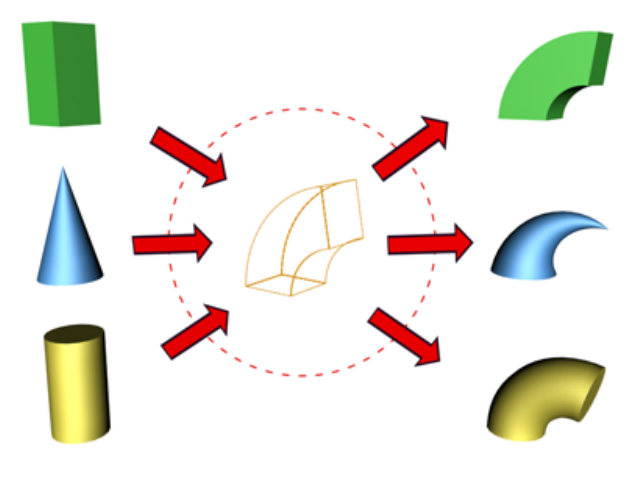
How Instanced Modifiers Work
When you apply a modifier to a selection set, the same modifier is carried on
the stack for each individual object. These are instanced modifiers: they are all
exactly the same, and a change to the instance for any one object will change
all the others.
In the stack, the name of an instanced modifier appears in italic.
Objects sharing a single instanced modifier
Identifying Instanced Modifiers
You can quickly lose track of which objects share the same modifier. An option
on the Views menu highlights those objects.
To identify objects sharing instanced modifiers:
1Select an object with an instanced modifier. Choose the instanced
modifier in its stack.
2Choose Views menu > Show Dependencies. Other objects with instances
of the same modifier appear in a distinctive color (purple by default).
1040 | Chapter 9 Modifiers
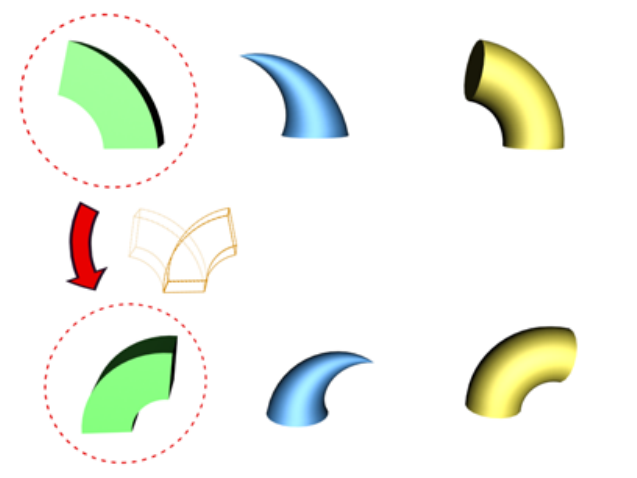
Adjusting Instanced Modifiers
You can make changes to an entire set of objects from a single instance. This
is a major advantage of instanced modifiers.
To adjust instanced modifiers:
1Select any object in a set of objects with instances of the same modifier.
2Choose the instanced modifier in its stack.
The single object highlights and the appropriate gizmos appear for the
entire selection set. Adjustments to this modifier now affect the entire
set.
Changing the parameter of an instanced modifier for one object affects all the
objects sharing the modifier.
Making Instanced Modifiers Unique
At some point in your work, you might want to turn a modifier instance into
a local copy that affects only a single object. To do so, click Make Unique on
page 7446 on the Modify panel. This button appears beneath the modifier stack
How Instanced Modifiers Work | 1041

display. (Make Unique is also available as a pop-up menu choice when you
right-click the instanced modifier's name in the stack display.)
To make an instanced modifier unique:
1Select an object with an instanced modifier.
2Choose the instanced modifier in its stack.
3 Click Make Unique beneath the modifier stack display. The modifier
is no longer listed in italic text and if Show Dependencies is set, the
highlight disappears from the other objects.
The modifier is now separate from the set of instanced modifiers.
Adjustments you make to this modifier no longer affect other objects. Its
parameters and gizmo remain unchanged from their original, instanced
settings until you adjust them.
To make multiple modifier instances unique:
1Select two or more objects with the same instanced modifier. The stack
now shows what the objects have in common.
2Choose the instanced modifier in the stack.
There can be more than one instanced modifier in this stack. Click the
one you want to make unique for each of the selected objects.
3 Click Make Unique.
4Right-click and choose Make Unique from the menu. The modifier is no
longer listed in italic text and if Show Dependencies is set, the highlight
disappears from the other objects.
5Click Yes to make the two objects become independent of one another.
Click No for the two objects to continue to share the same instanced
modifier, but separate from the instance in the original group.
The parameters for this modifier disappear, because the objects no longer
share the modifier. For each object, the modifier is now separate from
the set of instanced modifiers.
As with a single object, the parameters and gizmo are unchanged in the now
unique modifiers.
■To access the unique modifiers, select the objects individually.
1042 | Chapter 9 Modifiers

NOTE If both the object and the modifier are instances, you can choose either
in the stack before you click Make Unique.
World-Space Modifiers (WSMs)
World-space modifiers act as object-specific space warps. They are carried with
the object, but like space warps use world space on page 7976 rather than object
space for their effects. World-space modifiers eliminate the need for binding
to a separate space-warp gizmo, making them convenient for modifying a
single object or selection set.
You apply world-space modifier like you apply standard object-space modifier.
You can access world-space modifiers from the Modifiers menu, the Modifier
List in the Modify panel, and applicable modifier sets on page 7449 . A
world-space modifier is indicated by either an asterisk or the letters “WSM”
next to its name. (The asterisk or “WSM” distinguishes the world-space version
from the object-space version of the same modifier, if one exists.)
When you assign a world-space modifier to an object, it appears at the top of
the modifier stack, listed as a binding, in the same area as the space warp
bindings.
For a list of world-space modifiers, see List of Available Modifiers on page 1011
.
World-Space Modifiers and Earlier Space Warps
3ds Max 1 provided PathDeform and MapScaler space warps. In subsequent
versions, these were replaced by comparable world-space modifiers. When
you open a v1 MAX file in a later version of 3ds Max, objects bound to the
v1 space warps are automatically assigned the corresponding world-space
modifiers.
Camera Map Modifier (World Space)
Modify panel > Select an object. > Modifier List > World-Space Modifiers > *
Camera Map
Select an object. > Modifiers menu > UV Coordinates > * Camera Map
World-Space Modifiers (WSMs) | 1043
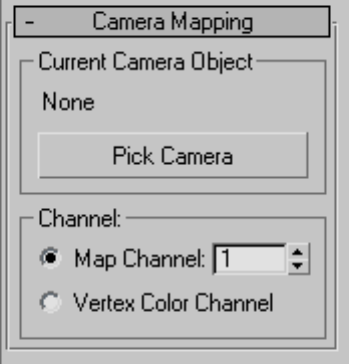
The Camera Map world-space modifier is similar to the Camera Map modifier
on page 1154 , in that it applies UVW mapping coordinates to the object based
on a specified camera. As a result, if you assign the same map as a Screen
environment to the background as you apply to the object, the object is
invisible in the rendered scene.
The main difference between the world-space version of Camera Map and the
object-space version is that, when you move the camera or the object using
the object-space version, the object becomes visible, because the UVW
coordinates are fixed to the object's local coordinates. When you move the
camera or object using the world-space version, the object remains invisible
because world coordinates are used instead.
Interface
Current Camera Object group
Label Names the current camera used for mapping. If there is no current
camera, reads "None."
Pick Camera Click this button, and then select the camera you want used
for mapping.
Channel group
Map Channel Specifies use of a map channel on page 7836 . Map channels
are specified in the Material Editor on page 5188 .
1044 | Chapter 9 Modifiers

Vertex Color Channel Specifies use of the Vertex Color Channel (see UVW
Map Modifier on page 1849 ).
Displace Mesh Modifier (World Space)
Select an object. > Modify panel > Modifier List > World-Space Modifiers > *
Displace Mesh
The Displace Mesh world-space modifier (World Space) lets you see the effect
of displacement mapping on page 5391 on editable mesh objects on page 1990
and objects with a Disp Approx modifier on page 1270 applied to them. If a
displacement map is applied to the object, the mesh shows the effect of the
displacement map. Displace Mesh replaces the mesh with its displaced version.
There are two main reasons for using Displace Mesh:
■As a visualization aid to see the effect of a displacement map in viewports,
and to compare the placement of displaced objects with other objects in
the scene.
For example, if you use an animated displacement map to create waves on
a water surface, you might temporarily apply Displace Mesh to see where
the ripples meet the waterline of a boat.
When you use Displace Mesh in this way, usually you delete it once you've
obtained the effect you want.
■To obtain an editable mesh created from a displacement map
To use the Displace Mesh this way, you apply it to the object that has a
displacement map, then apply the Snapshot command on page 921 from
the Tools menu, and choose Mesh as the clone method.
Snapshot creates a permanently displaced mesh. As it does for other kinds
of objects, Snapshot also leaves the original, displacement-mapped object
in the scene. After applying Snapshot, you can delete the original object,
or you can keep it in your scene to use for other purposes.
TIP Use Disp Approx to displace editable meshes. Use Displace Mesh for
previewing, as in the first item, but avoid using Snapshot. The mesh created
by using Displace Mesh and Snapshot can have a high polygon count. This
makes it slow to use interactively, and can cause smoothing problems, where
the underlying mesh edges are visible.
Displace Mesh Modifier (World Space) | 1045
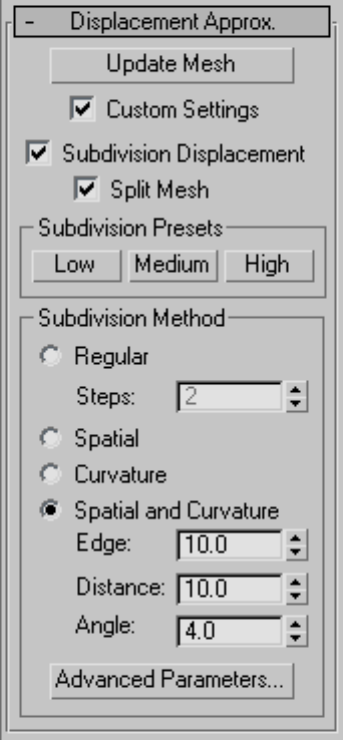
Interface
The rollout for Displace Mesh lets you choose which surface approximation
settings are used to produce the mesh.
Update Mesh Updates the mesh if you have changed the displacement
mapping and want to see the results of the change. The mesh isn't updated
automatically because that can become extremely time consuming.
1046 | Chapter 9 Modifiers
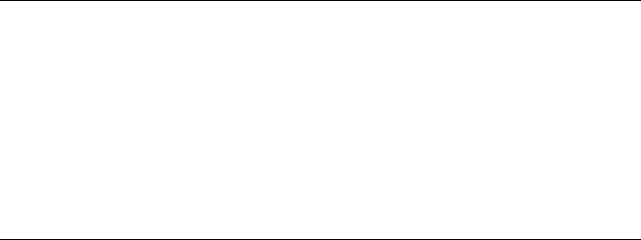
Custom Settings When turned off, Displace Mesh uses default settings to
subdivide the mesh for the purposes of displacement mapping. When turned
on, the subdivision controls in this rollout are enabled. Default=off.
Subdivision Displacement Subdivides mesh faces to accurately displace the
map, using the method and settings you specify in the Subdivision Presets
and Subdivision Method group boxes. When turned off, the modifier applies
the map by moving vertices in the mesh, the way the Displace modifier on
page 1274 does. Default=on.
Split Mesh Affects the seams of displaced mesh objects; also affects texture
mapping. When on, the software splits the mesh into individual faces before
displacing them; this helps preserve texture mapping. When off, the software
uses an internal method to assign texture mapping. Default=on.
TIP This parameter is required because of an architectural limitation in the way
displacement mapping works. Turning Split Mesh on is usually the better technique,
but it can cause problems for objects with clearly distinct faces, such as boxes, or
even spheres. A box's sides might separate as they displace outward, leaving gaps.
And a sphere might split along its longitudinal edge (found in the rear for spheres
created in the Top view) unless you turn off Split Mesh. However, texture mapping
works unpredictably when Split Mesh is off, so you might need to add a Displace
Mesh modifier and make a snapshot on page 921 of the mesh. You would then
apply a UVW Map modifier on page 1849 and then reassign mapping coordinates
to the displaced snapshot mesh.
Subdivision Presets group and Subdivision Method group
The controls in these two group boxes specify how the modifier applies the
displacement map when Custom Settings and Subdivision Displacement are
both turned on. They are identical to the surface approximation controls on
page 2469 for NURBS surfaces.
Displace NURBS Modifier (World Space)
Select a NURBS object. > Modify panel > Modifier List > World-Space Modifiers
> * Displace NURBS
The Displace NURBS world-space modifier (World Space) converts a NURBS
on page 2152 object into a mesh. If a displacement map is applied to the object,
Displace NURBS Modifier (World Space) | 1047
the mesh shows the effect of the displacement map in viewports. There are
two main reasons for using Displace NURBS:
■As a visualization aid to see the effect of a displacement map in viewports
When you use Displace NURBS this way, you usually delete the modifier
once you've obtained the effect you want.
■To obtain an editable mesh created from a displacement map on a NURBS
object
To use Displace NURBS this way, you apply it to the object that has a
displacement map, then use the Snapshot command on page 921 from
the Tools menu, and choose Mesh as the Clone Method.
Snapshot creates a permanently displaced mesh. As it does for other kinds
of objects, Snapshot also leaves the original, displacement-mapped object
in the scene. After applying Snapshot, you can delete the original object,
or you can keep it in your scene to use for other purposes.
Interface
The rollout for Displace NURBS lets you choose which surface approximation
settings are used to produce the mesh.
1048 | Chapter 9 Modifiers
Animated Displacement Map If you use an animated displacement map on
the mesh, turn on this toggle to have the NURBS Modifier correctly update
the mesh as the displacement map animates.
You can apply a displacement map on page 5391 using the Material Editor on
page 5188 .
Update Mesh Click to update the mesh if you have changed the displacement
mapping and want to see the results of the change. The mesh isn't updated
automatically because that could become extremely time consuming.
Viewport Uses the tessellation that the NURBS object currently uses in
viewports.
Renderer Uses the tessellation that the NURBS object currently uses for the
renderer.
Custom Set the tessellation directly in the Tessellation Method group box.
Base Surface, Surface Edge, Displaced Surface, and Lock These controls are
the same as in the surface approximation controls on page 2469 for NURBS
objects.
Tessellation Method group
The controls in this group are the same as the surface approximation controls
for NURBS objects.
Ignore Surface Settings When turned off, Displace NURBS uses the surface
approximation settings for surface sub-objects. When turned on, Displace
NURBS uses the settings in the Tessellation Method group and overrides
settings for surface sub-objects. Default=off.
Auto Weld All vertices closer than the Threshold value are automatically
welded together. This can simplify the mesh geometry. It is useful to turn this
on when you have increased the Merge value in order to eliminate gaps
between surface edges in the approximation of the NURBS object.
Hair And Fur Modifier
Modify panel > Make a selection. > Modifier List > World-Space Modifiers >
Hair And Fur
The Hair And Fur modifier is the heart of the Hair And Fur feature. You apply
it to any object that you want to grow hair from: either a mesh object or a
spline object. If object is a mesh, the hair grows from the entire surface unless
Hair And Fur Modifier | 1049
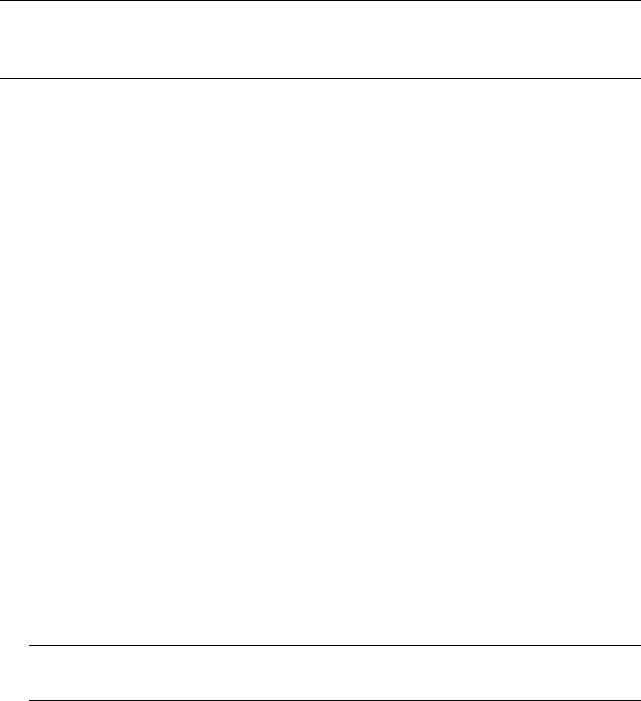
you make a sub-object selection. If the object is a spline, hair grows between
the splines.
When you select an object modified by Hair And Fur, hair is displayed in
viewports. The hair itself as displayed in the viewports is not selectable, though
hair guides are selectable when you work at the Guides sub-object level or style
hair (see below).
NOTE Hair And Fur renders only in Perspective and Camera views. If you attempt
to render an orthographic view, 3ds Max displays a warning that says the hair will
not appear.
Components of the Hair And Fur Feature
Hair And Fur in 3ds Max has a few different components in the interface:
■The Hair And Fur modifier is the main component. This is where you style
the hair guides, and set parameters for size and coloration, kinkiness,
frizziness, and so on.
■The Hair And Fur render effect on page 6386 more directly controls how
hair is rendered. Typically you don't need to change the render effect
parameters, unless you have special rendering requirements.
A Hair And Fur render effect is automatically added to your scene when
you apply the Hair And Fur modifier.
■A Hair Light Attributes rollout on page 5076 appears for all supported lights
when a Hair And Fur render effect is active using the scanline renderer,
and the render effect's Use All Lights At Render Time toggle is turned on.
Controls on this rollout let you fine-tune how hair shadows appear under
specific lights.
The following light types are not supported when rendering hair with the
“buffer” method (see “Lighting Considerations,” below): Skylight, mr Area
Omni, mr Area Spot, IES Sun, IES Sky, mr Sky and mr Sun. However, mr
Area Omni, mr Area Spot, mr Sky, and mr Sun are supported for hair when
you use the “mr prim” method and the mental ray renderer.
NOTE For the purposes of rendering shadows in hair, Direct lights are treated
as point (omni) lights.
■There is also a Hair And Fur render element on page 6163 , which you can
use when you are doing your own compositing.
1050 | Chapter 9 Modifiers
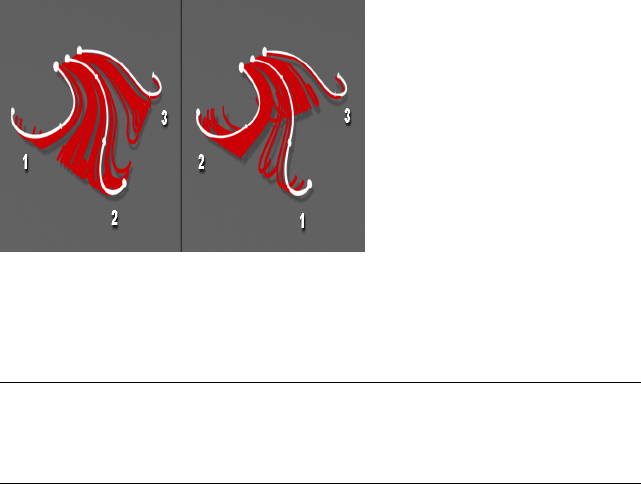
Growth Objects
You can grow Hair either from a surface or from splines.
To grow hair from a surface, select the object and then apply the Hair And
Fur modifier. You can use either geometric primitives or an editable surface
type such as Polymesh.
To grow hair from splines, you can draw several splines and combine them
into a single object (or turn off Start New Shape during creation), and then
apply the Hair And Fur modifier. You will see some preview interpolated hairs
appear in viewports. The order of the spline sub-objects is important because
Hair uses this order to interpolate hair in between the splines. If the
interpolation seems incoherent, you might need to physically rearrange the
splines.
Using a spline emitter, Hair interpolates hair growth between pairs of splines in logical,
numerical order.
Left: Splines in sequential order result in predictable hair growth.
Right: Splines in nonsequential order can produce undesirable results.
TIP To check the numerical order of splines, go to the Editable Spline level of the
modifier stack and access the Spline sub-object level. Then click each spline in turn
and check its ID number at the bottom of the Selection rollout. It also can help
to make sure that each spline's first vertex is where the hair roots should be.
Guide Hairs
Storing and manipulating millions of dynamic, simulated hairs is demanding
on today’s technology. Therefore, just as standard 3D graphics technology
uses boundaries such as surfaces to describe solid objects, Hair uses hair
“guides” to describe basic hair shape and behavior.
Hair And Fur Modifier | 1051
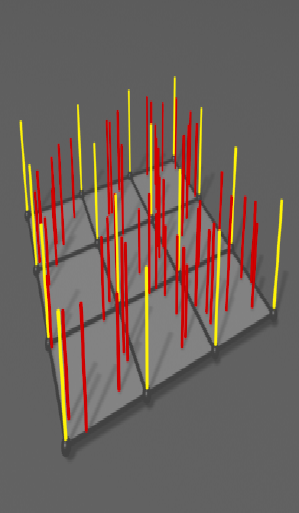
Guides (yellow) occur at each polygon corner.
Hairs (red) are interpolated between guides.
When the growth object is a surface, Hair And Fur generates guide hairs at
the corners of polygons. When the growth object is a spline, the spline
sub-objects are themselves the guides.
For surface-grown hair, you can manipulate the guides with styling tools on
page 1070 to form a “control volume” that gets populated by interpolated hairs.
The hairs can then be further manipulated with distorting controls such as
Kink on page 1104 and Frizz on page 1099 , which can be driven by maps or solid
textures.
1052 | Chapter 9 Modifiers
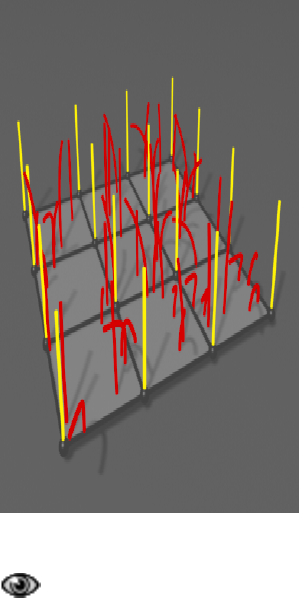
Frizz settings affect the hairs but not the guides.
By default, a percentage of hairs are displayed in the viewports, but
surface-grown guides do not appear except when you are working at the Guides
sub-object level. You can adjust the viewport display of guides and hairs with
settings on the Display rollout on page 1116 .
Guides are also used to calculate dynamics. After this calculation, hair
interpolation takes place when you render. This is when parameters such as
Frizz, as well as displacement and coloration, are calculated. You don't have
control of every single hair, but this two-phase process makes the creation of
realistic hair computationally feasible on a typical computer.
Styling Hair
The Hair And Fur modifier's growth settings have a great effect on the hair’s
appearance and behavior, but you can also manipulate the guides directly (or
in other words, style the hair).
For surface-grown hair, use the tools on the Styling rollout on page 1070 . First,
select the surface whose hair you want to edit, and then on the Modify panel,
Hair And Fur Modifier | 1053
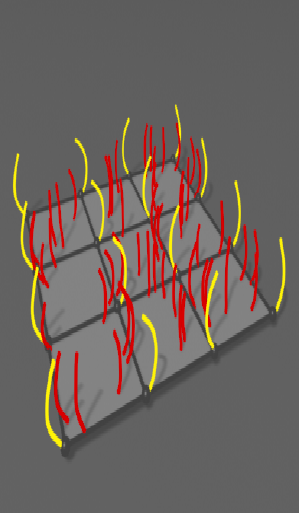
either click the Style Hair button on the Styling rollout or choose the Guides
sub-object level from the Selection rollout on page 1059 or the modifier stack
display.
After guides have been styled, hair is interpolated between neighboring guide pairs.
1054 | Chapter 9 Modifiers
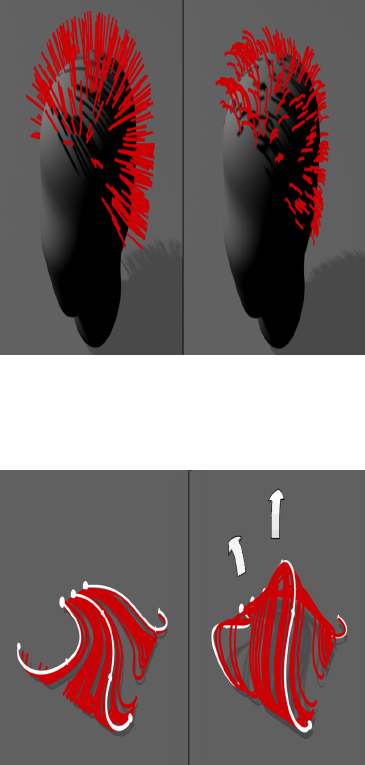
Mesh-based hair guides before and after styling.
With spline growth, you style the hair by editing the growth splines in the
viewports.
Style spline-based hair by manipulating the splines.
Copying and Pasting Hair
You can copy and paste a Hair And Fur modifier from one stack to another,
but you need to line up the objects as closely as possible, because Hair uses
proximity to determine how to position copied guides. If the objects have
significantly different geometry, the transfer of guides can be inaccurate.
Hair And Fur Modifier | 1055
Copying and pasting the Hair And Fur modifier automatically adjusts the hair
scaling. Copying from a large object to a small object, for instance, results in
a smaller default size in the copied modifier.
If you copy an object that has Hair And Fur in its modifier stack, Hair will also
copy the modifier’s data to a new modifier that will track the new object.
Textures,Vertex Maps, and Shaders
You can control many Hair And Fur modifier parameters with maps. If you
apply a map to a parameter that is not a color, such as Density, Hair uses the
texture as a grayscale map that is multiplied by the parameter value (0.0 to
100.0) .
You apply a map by clicking the square button to the right of the parameter.
After applying a map, the letter “M” appears on the button. To place this map
in the first slot in the Material Editor, Shift+click the button. To disable the
map temporarily, Ctrl+click the button. A disabled map is indicated by a
lower-case “m”.
Lighting Considerations
When you render using the default “buffer” method, Hair And Fur provides
its own default lighting (a single omni light), unless you have one or more
supported lights in the scene.
Supported lights for the scanline renderer and “buffer” method include
spotlights, omni lights, direct lights (which are treated as omni lights for hair
purposes), and photometric lights except for IES Sun and IES Sky. Supported
lights for the mental ray renderer and “mr prim” method include the lights
supported by the scanline renderer, and these mental ray light types: mr Area
Omni Light, mr Area Spotlight, mr Sky, and mr Sun.
If supported lights exist in the scene, by default they are used to light the hair,
and the internal default omni light is not used. This is because in the Hair
And Fur render effect on page 6386 , the Use All Lights At Render Time option
is on by default. Also, any supported lights set to cast shadow-mapped shadows
will cast shadows from rendered hair.
For Hair’s “buffer” render to consider only certain lights, select the lights you’d
like Hair to use, go to the Hair And Fur render effect, turn off Use All Lights
At Render Time, and then click Add Hair Properties. This causes only the
designated lights to illuminate the hair. It also adds a Hair Light Attr rollout
on page 5076 to each of the designated lights. This lets you fine-tune the light's
shadow settings for Hair.
1056 | Chapter 9 Modifiers

With the “buffer” method, you can also raytrace your scene.
NOTE The other rendering methods provided are “geometry” and “mr prim.”
The “geometry” method creates actual geometry for the rendered hair at render
time. The “mr prim” method uses a mental ray shader to generate hair, and is for
use only with the mental ray renderer. Use the Hair And Fur render effect to choose
the rendering method.
Loading and Saving
Hair And Fur data in your scene is automatically saved when you save your
MAX scene file. The state data for the hair can consume quite a bit of space,
so your scene file will probably be significantly larger than it was before you
applied hair.
Animating Hair
You cannot keyframe hair styling. You can keyframe Modify panel parameters
to create special effects such as hair growing. But to animate hair motion, you
can use the Frizz Animation parameters or use dynamics.
To animate frizz, use the Frizz Anim. on page 1104 , Anim. Speed, and Frizz
Anim. Dir. parameters. It's not necessary to keyframe these to create animation;
just set them to values other than the defaults.
To animate with dynamics, use the Dynamics rollout on page 1109 . See To
generate a precomputed dynamics simulation with Hair on page ? . A gravity
force is built in to Hair And Fur. You can add space warps to act as external
forces (for example, Wind).
See also:
■Hair and Fur Render Effect on page 6386
■Hair and Fur Render Element on page 6163
■Hair Light Attr(ibutes) Rollout on page 5076
Hair And Fur Modifier | 1057
Procedures
To use the Hair And Fur modifier:
This procedure lists the essential steps for growing hair on an object. For more
information, see other Hair And Fur topics in this help, and the tutorials in
the Autodesk 3ds Max Tutorials, available from Help menu > Tutorials.
1Apply the Hair And Fur modifier to a mesh or spline object.
The hairs appear in the viewports as brown lines.
2Set the modifier parameters according to the desired results (see Interface
on page 1058 ). Available settings include the number of hairs, length,
thickness, and coloring.
3Activate a Perspective or Camera viewport, and then render the scene.
Hair cannot render in an orthogonal viewport.
To apply hair to a limited area of a high-resolution object:
An efficient working method for applying hair to part of a high-poly-count
object is to use a low-poly proxy object.
1Create the object to which you wish to apply hair.
2Make a copy of the object in the same location as the original, remove
any geometry where hair shouldn't grow, and reduce the polygon count.
For example, you could use the MultiRes modifier on page 1493 .
3If the original object is to move, make the low-resolution proxy object a
child of the original object.
4Apply the Hair And Fur modifier to the low-resolution proxy object and
adjust as necessary.
5Make the low-resolution proxy object non-renderable (see General Panel
(Object Properties Dialog) on page 245 ). The hair will still render.
Interface
You control the Hair And Fur modifier from a series of rollouts on the Modify
panel. See these topics:
Selection Rollout (Hair and Fur) on page 1059
Tools Rollout (Hair and Fur) on page 1061
Styling Rollout (Hair and Fur) on page 1070
1058 | Chapter 9 Modifiers
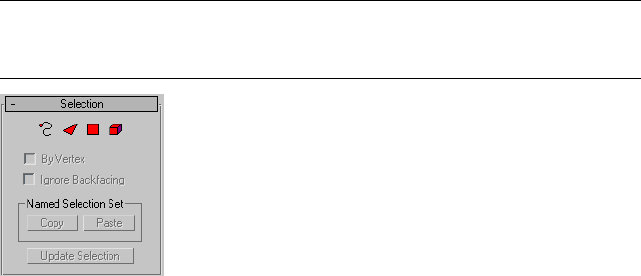
General Parameters Rollout (Hair and Fur) on page 1084
Material Parameters Rollout (Hair and Fur) on page 1091
mr Parameters Rollout (Hair and Fur) on page 1098
Frizz Parameters Rollout (Hair and Fur) on page 1099
Kink Parameters Rollout (Hair and Fur) on page 1104
Multi Strand Parameters Rollout (Hair and Fur) on page 1107
Dynamics Rollout (Hair and Fur) on page 1109
Display Rollout (Hair and Fur) on page 1116
Selection Rollout (Hair and Fur)
Select an object with the Hair And Fur modifier applied. > Modify panel >
Selection rollout
The Selection rollout provides tools for accessing different sub-object levels
and display settings and for creating and modifying selections, and displays
information about selected entities.
When you first apply the Hair And Fur modifier to an object, the entire object
is affected by the modifier. You can specify that the only part of an object
should grow hair by accessing a sub-object level and making a selection.
Clicking a button here is the same as choosing a sub-object level in the modifier
stack display. Click the button again to turn it off and return to the Object
selection level.
Interface
NOTE Controls on this rollout are available only when the growth object is a mesh.
If the growth object is a spline, the Selection controls have no effect, and sub-object
levels for the Hair And Fur modifier are not visible in the modifier stack.
Hair And Fur Modifier | 1059
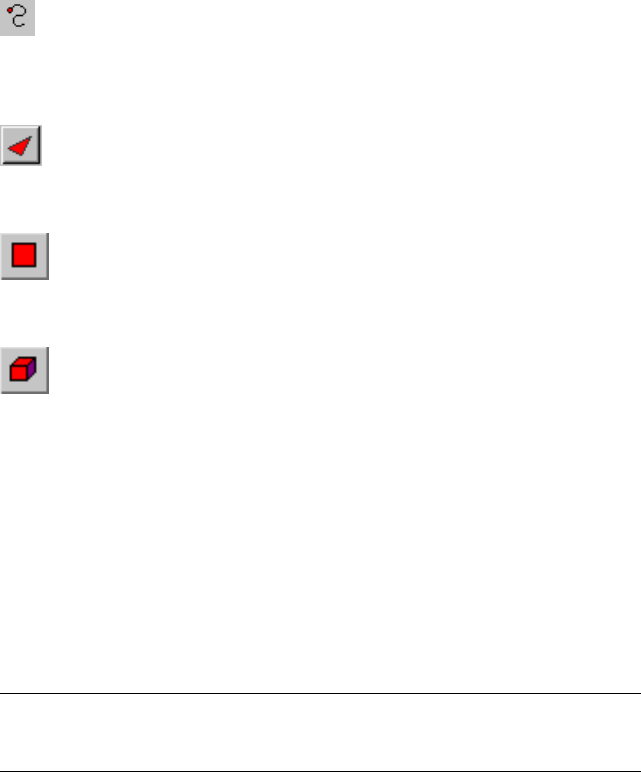
Guides Accesses the Guides sub-object level, which lets you edit the
styling guides using tools on the Styling rollout on page 1070 . When you click
Guides, the Style Hair button on the Styling rollout is automatically turned
on, and vice versa.
Face Accesses the Face sub-object level, which lets you select a triangular
face beneath the cursor; region selection selects multiple triangular faces within
the region.
Polygon Accesses the Polygon sub-object level, which lets you select
polygons beneath the cursor. Region selection selects multiple polygons within
the region.
Element Accesses the Element sub-object level, which lets you select
all contiguous polygons in an object by clicking once. Region selection lets
you select multiple elements.
By Vertex When on, you can select a sub-object only by selecting a vertex
that it uses. When you click a vertex, all sub-objects that use the selected
vertex are selected.
Ignore Backfacing When on, using the mouse to select sub-objects affects
only those facing you. When off (the default), you can select any sub-objects
under the mouse cursor, regardless of their visibility or facing. If there are
more than one sub-object under the cursor, repeated clicking cycles through
them. Likewise, with Ignore Backfacing off, region selection includes all
sub-objects, regardless of the direction they face.
NOTE The state of the Backface Cull setting on the Display panel does not affect
sub-object selection. Thus, if Ignore Backfacing is off, you can still select sub-objects,
even if you can't see them.
Named Selection Set group
Copy Places a named selection into the copy buffer.
Paste Pastes a named selection from the copy buffer.
1060 | Chapter 9 Modifiers
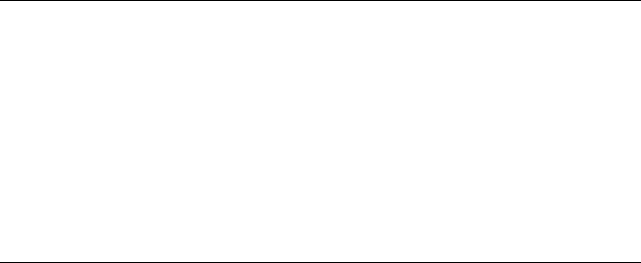
TIP You can use this to grow hair from an existing selection lower on the stack.
However, because the Hair And Fur modifier outputs an editable mesh, the copied
sub-object selection should be from a mesh-based modifier. For example, if your
base object is an editable poly, you can use tools such as Ring, Loop, and Grow
to make a procedural edge selection, and then Ctrl+click the Polygon button on
the Selection rollout to convert the selection to polygons. Next, apply a Mesh
Select modifier ( not Poly Select), and go to the Polygon sub-object level; the
Mesh Select modifier inherits the Editable Poly selection. Use the Named Selection
Sets field on the main toolbar to name the selection, and then use the Mesh Select
modifier's Copy function on the named selection. Finally, apply the Hair And Fur
modifier, go to the Poly sub-object level, and paste the selection.
Update Selection Recalculates the area from which hair is grown, based on
the current sub-object selection, and refreshes the display.
When you access a sub-object level within the Hair modifier and make a
selection, the area of hair growth doesn't automatically update. Click Update
Selection to view the results of a change in sub-object selection.
Tools Rollout (Hair and Fur)
Select an object with the Hair And Fur modifier applied. > Modify panel >
Tools rollout
This rollout provides tools for accomplishing a variety of tasks with Hair,
including creating a hairstyle from an existing spline object, resetting the hair,
and loading and saving general presets for the modifier as well as specific
hairdos. Here you can also specify an object from the current scene to be used
as hair, such as a flower or group of flowers for creating a garden.
Using Instanced Hair
Besides the built-in hair strands, which are created at render time, you can
assign any source object as hair strands, using the Instance Node controls on
the Tools rollout. For example, in the following illustration, the original
orientation of the source object affects its orientation when it is used as hair
strands.
Hair And Fur Modifier | 1061
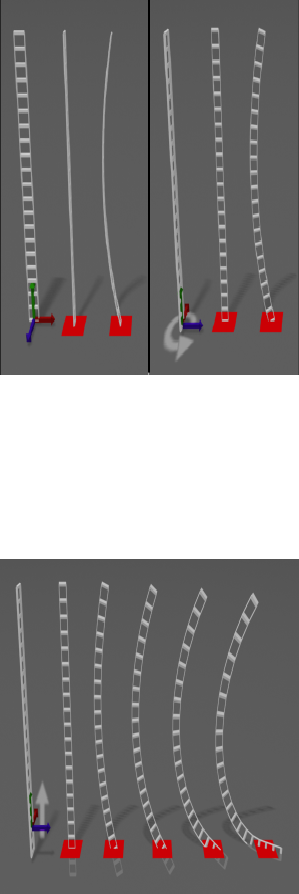
Rotating the source object affects the hair orientation.
The next illustration shows how increasing the Frizz Root value creates greater
amounts of distortion in the resulting instanced hairs. This image also shows
how a raised pivot in the source object causes the root of the hair to go below
the surface of the growth object (the red square). Compare this with the
previous illustration, in which the pivot rests at the base of the source object.
Frizz causes the instanced hairs to change shape.
The next illustration shows the effect of the Merge Material check box. On
the left side, Merge Material was left on, with the result that the flower model
1062 | Chapter 9 Modifiers
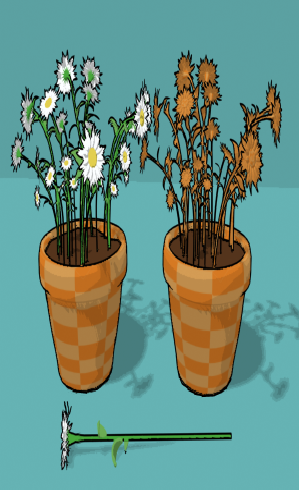
retained its original material and coloring when used as hair. On the right,
Merge material was turned off, so the flower-hairs took on the material of the
flower pot growth object.
Left: Merge Material on
Right: Merge Material off
In the next illustration, the Root Thick setting, from left to right, is 2.0, 10.0,
20.0, and 30.0. With instanced geometry, the Root Thick value affects the
thickness of the resulting object uniformly along its height, while the Tip
Thick value has no effect. (The Root Thick and Tip Thick settings are on the
General Parameters rollout on page 1084 .)
Hair And Fur Modifier | 1063
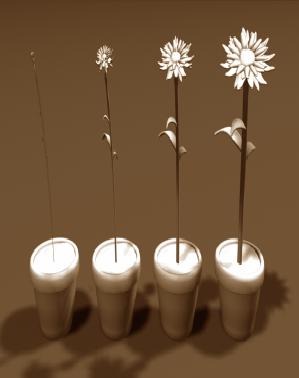
Increasing Root Thick affects the overall thickness of the hair geometry.
From left to right: Root Thick = 2.0, 10.0, 20.0, and 30.0
The final illustration, below, shows how the instanced hair aligns itself
faithfully to the guides, no matter how they're styled. The styled hair was
brushed from the center, and the instances align perfectly in all directions,
face up, without twisting or other distortion. This makes it easy to style
instances as scales, for example.
1064 | Chapter 9 Modifiers

Top left: The original styled hair
Top right: The instanced hair (arrows) conforms to the styling.
Bottom: Close-up view of instanced hair
Interface
Hair And Fur Modifier | 1065
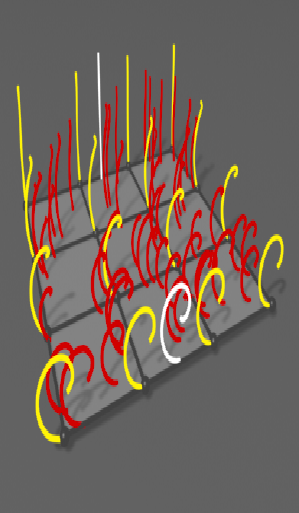
Recomb From Splines Lets you use a spline object to style the hair. Click
this button and then select an object that is made up of spline curves. Hair
will turn the curves into guides and populate each guide of the selected growth
mesh with a replica of the closest curve.
This tool is particularly useful for creating a specific style and length, such as
short hair with a part on the side, without having to manually groom the hair
in the Style dialog. For optimal control, position the splines fairly closely
together and use as many as possible.
Hair and guides are recombed by the spline object (white).
Reset Rest Performs an averaging of hair guides using the growth mesh’s
connectivity.
This function is particularly useful after using Recomb From Splines. It's also
advantageous when you change the size ratios of polygons in the growth
object. For example, if you stretch part of the mesh by moving some vertices,
by default the larger polygons will contain fewer hairs per unit area. Use Reset
Rest to redistribute the number of hairs on the surface for more even coverage.
1066 | Chapter 9 Modifiers
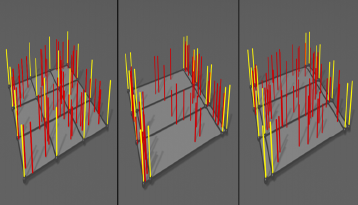
Left: Even hair distribution before resizing polygons
Center: Uneven hair distribution after moving edges, altering polygon size ratios
Right: After using Reset Rest, distribution is again evened out.
Regrow Hair Discards any styling information, resetting the hair to its default
state, retaining all current Modify panel settings.
Presets group
Lets you load and save hair presets. Each preset contains all current Modify
panel settings (except Display settings), but not any styling information.
Load Opens the Hair Presets dialog, which contains a list of presets in the
form of named swatches. To load a preset, double-click its swatch. Several
sample presets are included with 3ds Max.
Hair And Fur Modifier | 1067
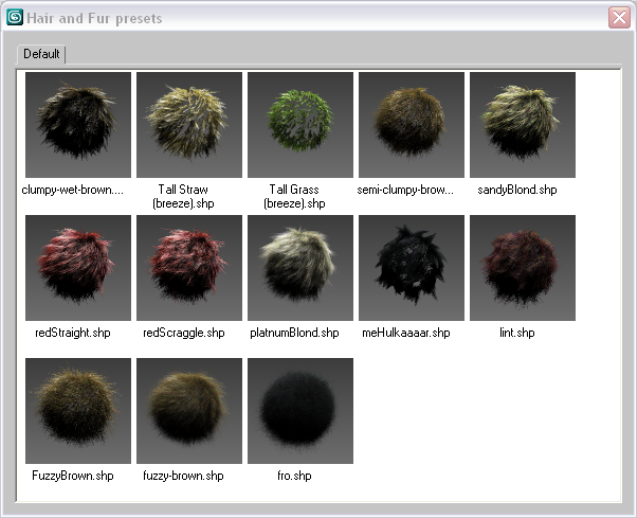
Hair And Fur Presets dialog
Save Creates a new preset. You're prompted for a preset name; after entering
one, Hair renders the swatch, as shown by a message on the status bar. You
can abort the creation of the preset by clicking the Cancel button on the status
bar during rendering. If you enter an existing preset name, Hair asks you to
confirm overwriting the preset.
Hairdo group
Lets you copy and paste hairdos. Each hairdo contains all the current Modify
panel settings (except Display settings) and styling information. This lets you
apply all hair settings from one object to another.
Copy Copies all hair settings and styling information into a paste buffer.
Paste Pastes all hair settings and styling information to the current
Hair-modified object.
1068 | Chapter 9 Modifiers
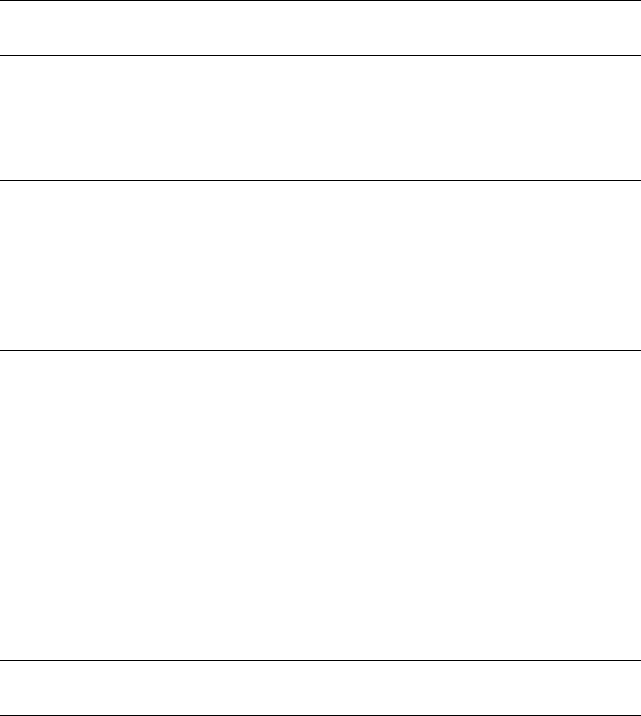
Instance Node group
Lets you specify an object to use as custom hair geometry. The hair geometry
is not instanced from the original object, but all hairs created from it are
instances of each other, to save memory.
NOTE Hair does not use animation from instance objects. If an object is animated,
Hair uses its state at the first animation frame.
Pick To specify a hair object, click the Pick button and then pick an object
to use. Thereafter, the button shows the name of the object you picked. To
use a different instance object, or to use a modified version of the original
object, click this button and then pick the new object.
TIP In order for the instances to be properly scaled and fit to the hair, place the
model's pivot at the “root” of the object. Hair will then scale your model
appropriately so that the height of each instance matches the length of the hair
it has been applied to. Any part of your model that extends below the pivot will
intersect the surface. This can be useful; if the hair grows at an oblique angle to
the growth surface, you can raise the pivot in the original model to make sure the
instanced hairs will extend all the way to the growth surface.
Also, bear in mind that the instancing engine will be deforming your model
as it fits it to the hairs. Make sure that your model has enough divisions along
the Z (vertical) axis for the deformation to look as smooth as it needs to; the
number of subdivisions should be approximately equal to the Hair Segments
value. Hair doesn't perform automatic subdivision on the geometry.
XTo stop using the instance node, click the Clear Instance button (labeled
“X”).
Merge Material When on, combines the material applied to the growth
object and the material applied to the hair object into a single Multi/Sub-Object
material and applies it to the growth object. When off, the growth object's
material is applied to the instanced hair. Default=on.
NOTE The merged material is instanced from the instance node, so that changing
the original material affects the resulting material applied to the hair.
Convert group
Use these controls to convert guides or hair generated by the Hair And Fur
modifier to 3ds Max objects that you can operate on directly.
Hair And Fur Modifier | 1069

Guides -> Splines Copies all guides to a new, single spline object. The original
guides are left intact.
Hair -> Splines Copies all hairs to a new, single spline object. The original
hairs are left intact.
Hair -> Mesh Copies all hair to a new, single mesh object. The original hairs
are left intact.
Render Settings Opens the Effects panel and rollout on page 6383 and adds
a Hair And Fur render effect on page 6386 to the scene, if one doesn't already
exist.
NOTE The Hair And Fur render effect settings are global, so even if you click Render
Settings to open the effect settings from different Hair And Fur modifiers, you'll
get the same render-effect settings.
Styling Rollout (Hair and Fur)
Select an object with the Hair And Fur modifier applied. > Modify panel >
Styling rollout
The Guides sub-object level of the Hair And Fur modifier on page 1049 lets you
style hair interactively in viewports. Interactive styling controls are on the
Styling rollout, which has a Style Hair button that you can also click to begin
styling.
Styling with Hair Guides
Styling tools aren't available until you click Style Hair to turn it on, or choose
the Guides sub-object level in either the Selection rollout or the modifier stack.
Each guide hair has 15 segments and 14 vertices (there's an additional,
non-selectable vertex at the root); for a tool to affect a guide, at least one of
its vertices must be selected. To select vertices, click Select (in the Styling
group) to turn it on, then use standard 3ds Max selection tools to select a
portion of the guides. For example, you might drag a selection rectangle to
select vertices on adjacent hair guides. By default, selected guides are displayed
as orange, and unselected guides are displayed as yellow.
Selections you make this way are constrained by the buttons at the top of the
Selection group: Select Hair By Ends, Select Whole Guide (the default), Select
Guide Vertices, or Select Guide By Root. As these names imply, the constraints
affect how the Hair Brush modifies hair guides. The best way to get a feel for
1070 | Chapter 9 Modifiers
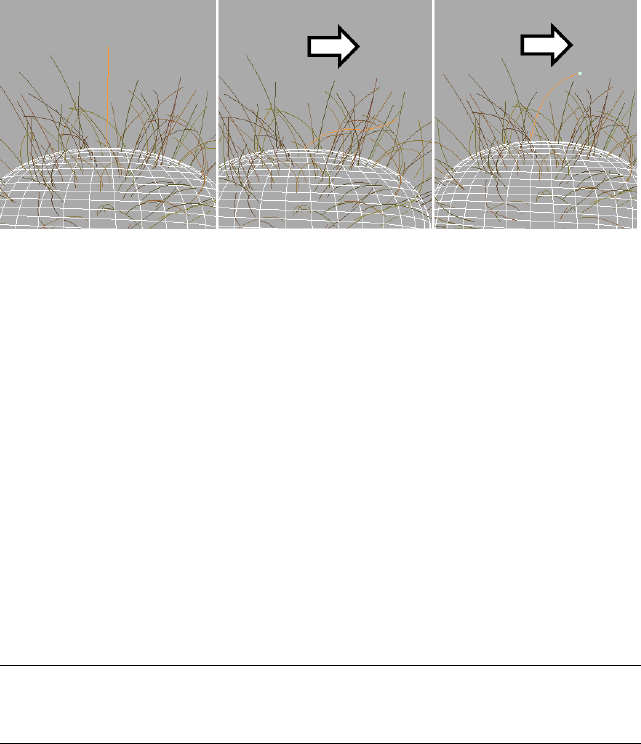
the difference between selection constraints is to practice using the various
selection constraints with tools such as Translate. The Hair Brush uses a
combination of these constraints and IK to alter guide geometry.
Left: Hair guide before styling
Center: Translating while Select Whole Guide is active
Right: Translating while Select Hair By Ends is active
Once you've made a selection, typicall you will click Hair Brush (also in the
Styling group, to the left of Select), and then use the brush in conjunction
with one of the tools at the bottom of the Styling group: Translate, Stand,
Puff Roots, Clump, Rotate, or Scale.
While you style, only selected guides are affected, and in addition, only guides
that fall within the brush area are affected at any given time. You can change
the brush size using the slider in the Styling group, or by holding down
Ctrl+Shift and dragging the mouse.
The Hair Cut tool on the Styling rollout (between Hair Brush and Select) cuts
hair guides by scaling them based on the brush location.
Interface
NOTE Controls on this rollout are available only when the growth object is a mesh.
If the growth object is a spline, the Styling controls have no effect. Instead, you
can style the hair by editing the underlying spline object.
Hair And Fur Modifier | 1071

Style Hair / Finish Styling Click Style Hair to begin styling. Click Finish
Styling to turn off styling mode. When you turn this button on, a brush is
immediately available and by default the active tool is Translate. Turning on
Style Hair turns on the Guides sub-object level in the Selection rollout on
page 1059 , and vice versa.
Selection group
Select Hair by Ends You can select only the vertex at the end of each
guide hair.
Select Whole Guide (The default.) Selecting any vertex on a guide hair
selects all vertices on the guide hair. When you first turn on Style Hair, Hair
activates this mode and selects all vertices of all guide hairs.
1072 | Chapter 9 Modifiers
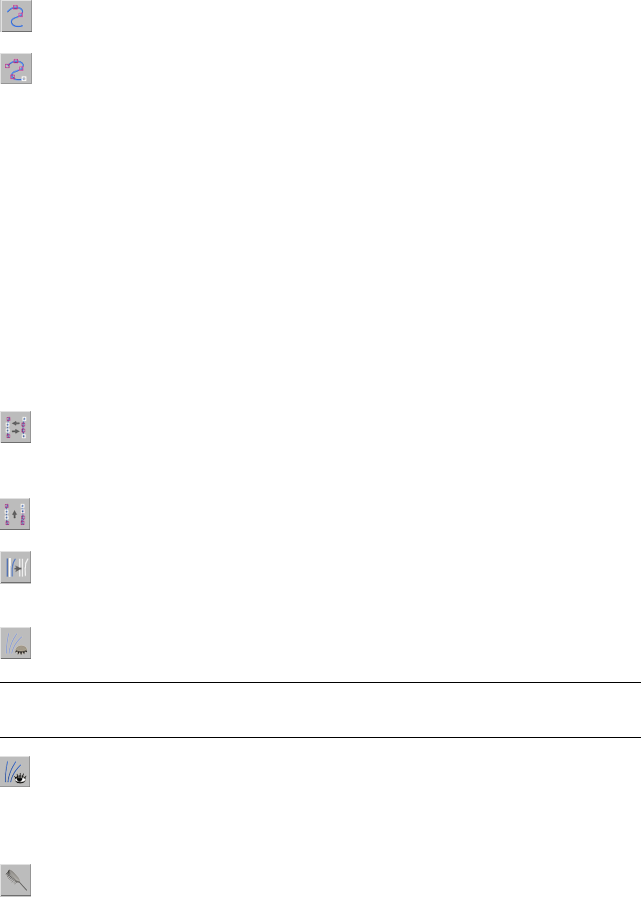
Select Guide Vertices You can select any vertices on a guide hair.
Select Guide by Root You can select only the vertex at the root of each
guide hair, and doing so selects all vertices on the guide hair.
Vertex display drop-down list Chooses how selected vertices are displayed
in viewports.
■Box Marker (The default.) Selected vertices display as small squares.
■Plus Marker Selected vertices display as small plus signs.
■X Marker Selected vertices display as small Xes.
■Dot Marker Selected vertices display as dots.
Selection Utilities The buttons labeled “Selection Utilities” are for handling
selections.
Invert Selection Inverts the vertex selection.
Keyboard shortcut: Ctrl+I
Rotate Selection Rotates the selection in space.
Expand Selection Expands the selection by growing its area
incrementally.
Hide Selected Hides selected guide hairs.
TIP If interactive styling in viewports seems to be slow, try hiding those guides
you aren't working on.
Show Hidden Unhides any hidden guide hairs.
Styling group
Hair Brush (The default.) In this styling mode, dragging the mouse affects
only selected vertices within the brush area.
Hair And Fur Modifier | 1073
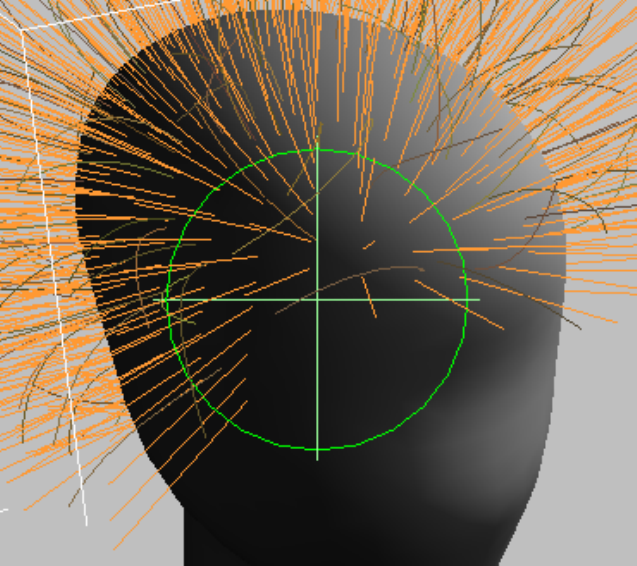
While Hair Brush is on, a brush gizmo is displayed in viewports. In the active
viewport, the brush appears as a circle, but as you can see in the other
viewports, the brush is actually a three-dimensional cylindrical region.
In the active viewport, the brush appears to be a circle.
1074 | Chapter 9 Modifiers
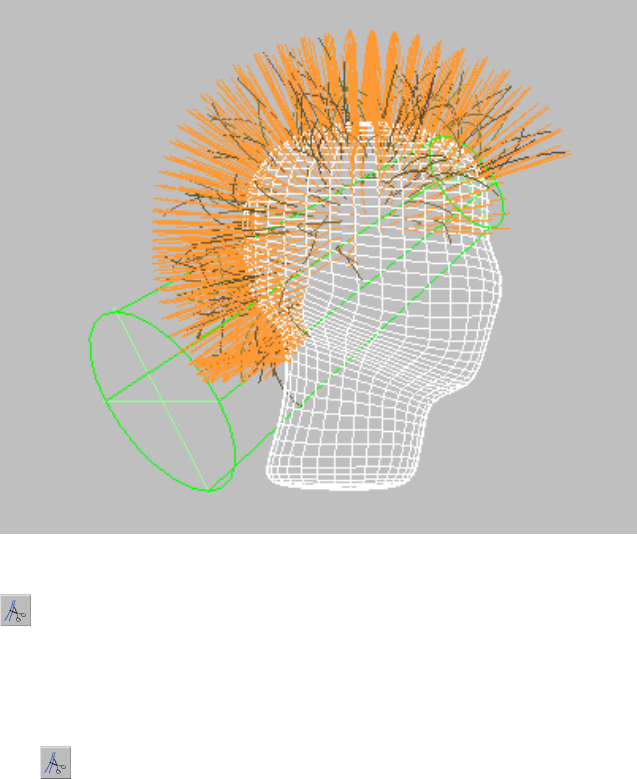
Inactive viewports show the brush to be a cylindrical region.
Hair Cut Lets you trim the guide hairs. To cut hair, follow this suggested
procedure:
1In Selection mode, choose any selection method.
2Drag the mouse to select guide hairs to trim.
3 Turn on Hair Cut.
4Resize the brush using the slider.
5Position the brush circle over hairs to cut, and then click to cut the hairs.
Hairs with vertices inside the brush circle are shortened so that their
endpoints touch the brush circle.
Hair And Fur Modifier | 1075
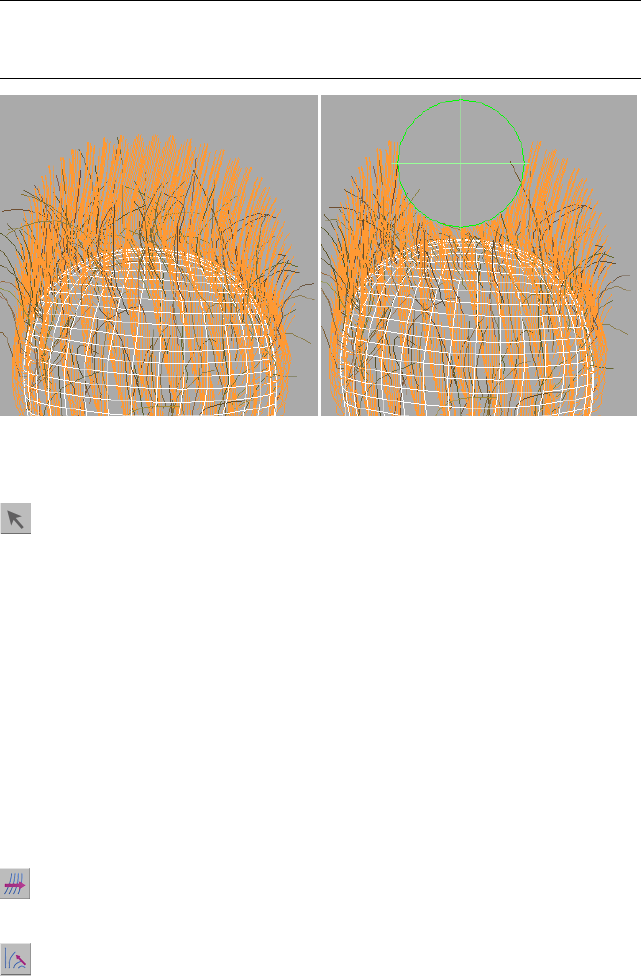
NOTE Cutting hair doesn't actually remove vertices; it only scales the guide hairs.
You can restore guide hairs to their original length with Scale or one of the Pop
commands on page 1079 .
Left: Hair guides before cutting
Right: Hair guides after cutting
Select Goes into selection mode, where you can use 3ds Max selection
tools to select guide vertices according to the constraints chosen in the
Selection group (Whole Guide, Ends, and so on).
Distance Fade Available only for Hair Brush. When on, the effect of brushing
fades toward the edges of the brush, giving a gentler effect. When off, brushing
affects all selected vertices equally, giving a hard-edged effect. Default=on.
Ignore Back Hairs Available only for Hair Brush and Hair Cut. When on,
hairs on back faces are not affected by the brush. Default=off.
Brush size slider Drag this slider to change the size of the brush.
Keyboard shortcut: Ctrl+Shift+drag
The styling buttons below the Brush Size Slider are available only while Hair
Brush is on.
Translate Moves selected vertices in the direction that you drag the
mouse.
Stand Pushes selected guides toward a perpendicular orientation to the
surface.
1076 | Chapter 9 Modifiers
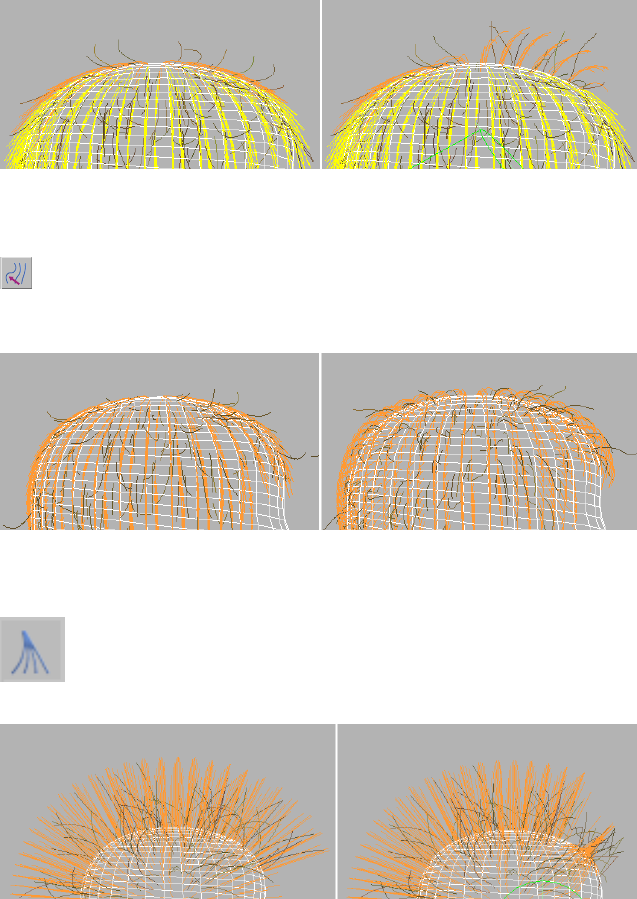
Left: Guide hairs before styling with Stand
Right: Guide hairs after styling with Stand (on the right)
Puff Roots Pushes selected guide hairs toward a perpendicular orientation
to the surface. The bias for this tool is closer to the root of the hair than to
the endpoint.
Left: Hair guides before puffing roots
Right: Hair guides after puffing roots
Clump Forces selected guides to move towards each other (drag
mouse leftward) or farther apart (drag mouse rightward).
Left: Hair guides before clumping
Right: Hair guides after clumping (at the right)
Hair And Fur Modifier | 1077
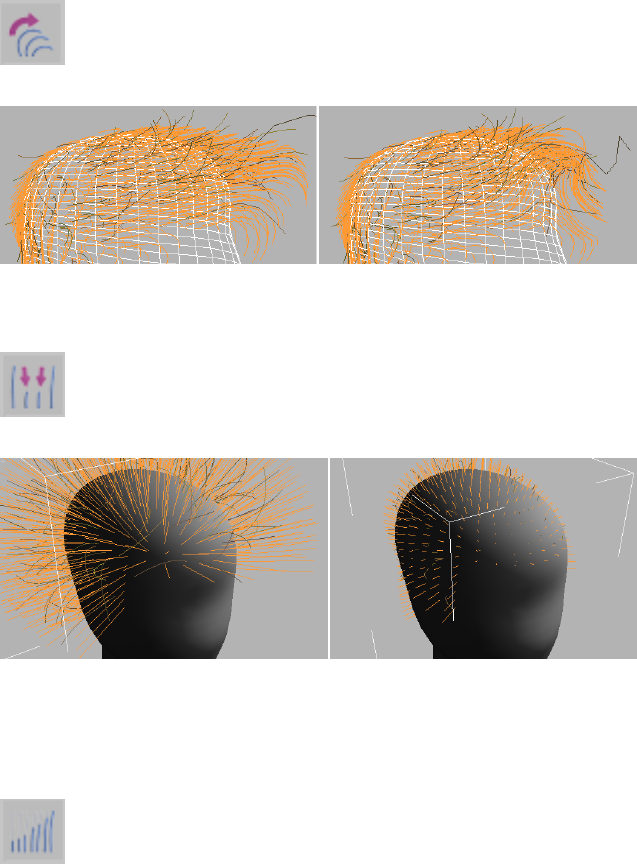
Rotate Rotate or swirls guide hair vertices around the cursor location
(at the center of the brush).
Left: Hair guides before rotating
Right: Hair guides after rotating (at the forelock)
Scale Scales selected guides larger (drag mouse rightward) or smaller
(drag mouse leftward).
Left: Hair guides at original lengths
Right: Hair guides after scaling shorter
Utilities group
Attenuate Length Scales selected guides according to the surface
area of underlying polygons. This is useful, for example, in applying fur to an
animal model, which typically has smaller polygons in areas with shorter hair.
For example, the polygons on an animals paws are usually smaller than the
ones on the chest, and the chest fur tends to be longer.
1078 | Chapter 9 Modifiers
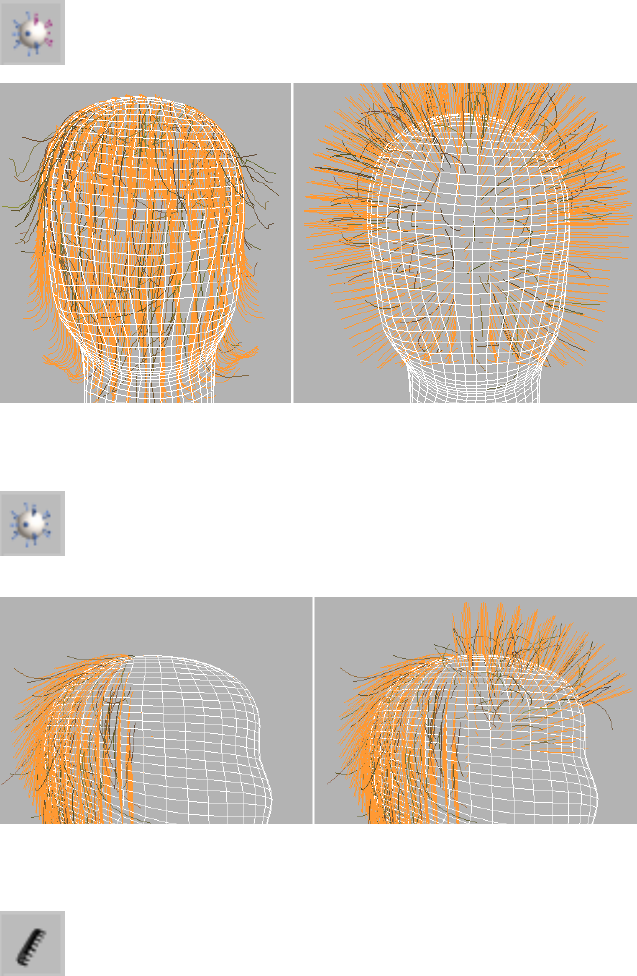
Pop Selected Pops selected hairs out along the surface normal.
Left: Hair guides before using Pop Selected
Right: Hair guides after using Pop Selected
Pop Zero-Sized Works like Pop Selected, but only operates on
zero-length hairs.
Left: Hair guides on top of head were scaled to zero length.
Right: Using Pop Zero affects only the zero-length hair guides.
Recomb Makes a guide parallel to the surface, using the guide's
current direction as a hint.
Hair And Fur Modifier | 1079
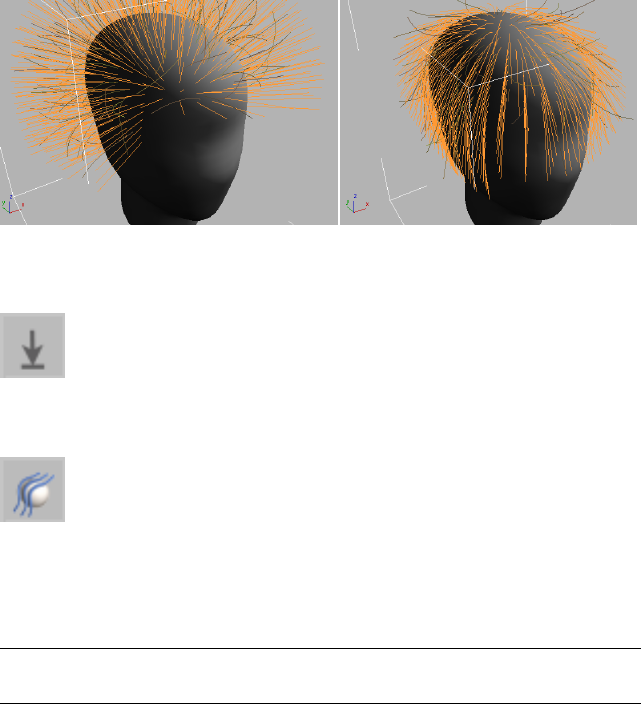
Here’s a suggested procedure: Turn on Hair Brush, select guides using Select
Whole Guide, and then move the guides around not worrying about skin
penetration or hair shape. You’re just trying to indicate the direction of the
hair flow. Click Recomb frequently, and you will soon start to see hair flowing
smoothly wherever you want it to. Once you have this flow, you can do your
other styling. With the Recomb tool, you probably won't need to use Comb
Away. Once you have the flow as you like it, you can go in and start styling
in scale, cut guides, and move some of the tips around, “shaping” or “styling”
the hair.
Left: Hair guides in their default position
Right: Hair guides after clicking Recomb
Reset Rest Performs an averaging of hair guides using the growth
mesh’s connectivity.
This function is particularly useful after using Recomb.
Toggle Collisions When on, styling takes hair collisions into account.
When off, styling ignores collisions. Default=off.
For collisions to be used while styling, you need to have already added at least
one collision object using the Dynamics rollout on page 1109 . If no collisions
are specified, this button has no effect.
TIP If you collisions are enabled and styling interaction seems slow, try turning
off Toggle Collisions.
1080 | Chapter 9 Modifiers

Toggle Hair Toggles viewport display of generated (interpolated)
hair. This doesn't affect display of the hair guides. Default=on (hair is
displayed).
Lock Locks selected vertices with respect to the orientation to and
distance from the nearest surface. Locked vertices can be selected, but they
can't be moved.
This is useful for creating different types of hair shapes. For example, to make
a braid, you would comb hair down some straight tubes, and then lock the
vertices to the tubes. Then, in 3ds Max, when you twist the tubes, the hairs
will follow. Locked vertices are no longer dynamic, although they will follow
whatever the surface does, but if other vertices on the same guides aren't
locked, they can still move freely, as usual.
Unlock Unlocks all locked guide hairs.
Undo Reverses the most recent action.
Keyboard shortcut: Ctrl+Z
Hair Groups group
Split Selected Hair Groups Splits the selected guides into a group.
This can be useful for creating a part or a cowlick, for example.
Merge Selected Hair Groups Recombines selected guides.
If you don't use Split Selected Hair Groups, then when you render hair, the
generated hairs are interpolated across a styled part. When Split Selected Hair
Groups is on, there is no interpolation between the split group and other
hairs. To remove this effect and make the part less “clean,” click Merge Selected
Hair Groups.
Hair And Fur Modifier | 1081
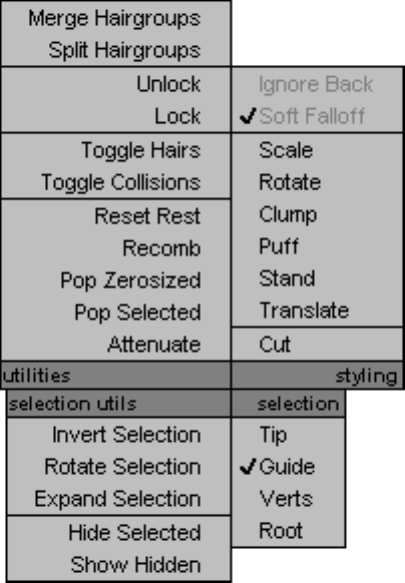
Quad Menu for Hair Styling
While you are styling hair at the Guides sub-object level, right-clicking a
viewport displays a quad menu that contains shortcuts to many styling controls
that are also found on the Styling rollout on page 1070 .
Interface
Utilities quadrant
The first two choices are shortcuts to the buttons in the Hair Groups group:
■Merge Hairgroups on page 1081
■Split Hairgroups on page 1081
1082 | Chapter 9 Modifiers

The other choices in this quadrant are shortcuts to the buttons in the Utilities
group:
■Unlock on page 1081
■Lock on page 1081
■Toggle Hairs on page 1081
■Toggle Collisions on page 1080
■Reset Rest on page 1080
■Recomb on page 1079
■Pop Zerosized on page 1079
■Pop Selected on page 1079
■Attenuate on page 1078
Styling quadrant
The choices in this quadrant are shortcuts to most of the controls in the Styling
group:
■Ignore Back on page 1076
■Soft Falloff on page 1076
■Scale on page 1078
■Rotate on page 1078
■Clump on page 1077
■Puff on page 1077
■Stand on page 1076
■Translate on page 1076
■Cut on page 1075
To exit Cut mode and return to the hair brush, choose one of the other
styling modes in this quadrant.
TIP While the brush is active, you can resize it in viewports by holding down
Ctrl+Shift and dragging the mouse.
Hair And Fur Modifier | 1083
Selection Utils quadrant
These choices are shortcuts to the buttons under “Selection Utilities” in the
Selection group:
■Invert Selection on page 1073
■Rotate Selection on page 1073
■Expand Selection on page 1073
■Hide Selected on page 1073
■Show Hidden on page 1073
Selection quadrant
These choices are shortcuts to the buttons at the top of the Selection group
that constrain how you can select hair guides:
■Tip on page 1072
■Guide on page 1072
■Verts on page 1073
■Root on page 1073
General Parameters Rollout (Hair and Fur)
Select an object with the Hair And Fur modifier applied. > Modify panel >
General Parameters rollout
This rollout lets you set the hair count and density, the length, thickness at
the root and tip, and various other comprehensive parameters.
1084 | Chapter 9 Modifiers
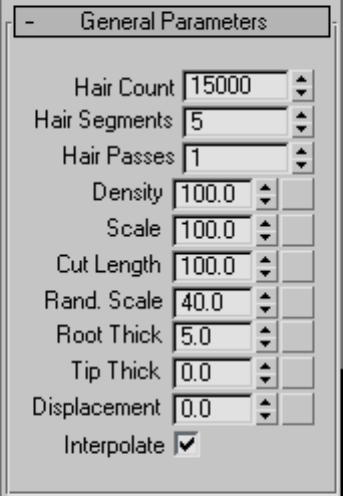
Interface
Hair Count The total number of hairs generated by Hair. In some cases this
is an approximate count, but the actual count is usually very close to the
specified quantity. Default=15000. Range=0 to 10000000 (ten million).
Hair And Fur Modifier | 1085
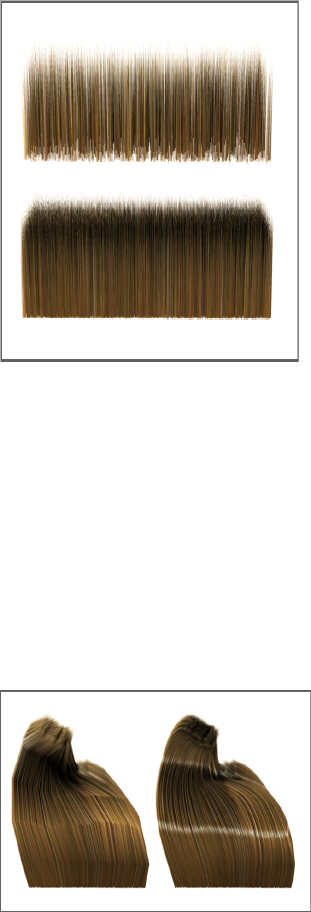
Top: Hair Count=1000
Bottom: Hair Count=9000
By default, Hair normalizes density to surface area; that is, larger polygons
receive more hairs than smaller ones. If you edit the growth object in a way
that changes the polygon-size ratios, use Reset Rest on page 1066 to adjust the
hair distribution automatically.
Hair Segments The number of segments per hair. Default=5. Range=1 to
150.
This is equivalent to spline segments; with more segments, curly hair looks
more natural, but the generated mesh object is larger. For perfectly straight
hair, set Hair Segments to 1.
Left: Hair Segments=5
Right: Hair Segments=60
1086 | Chapter 9 Modifiers
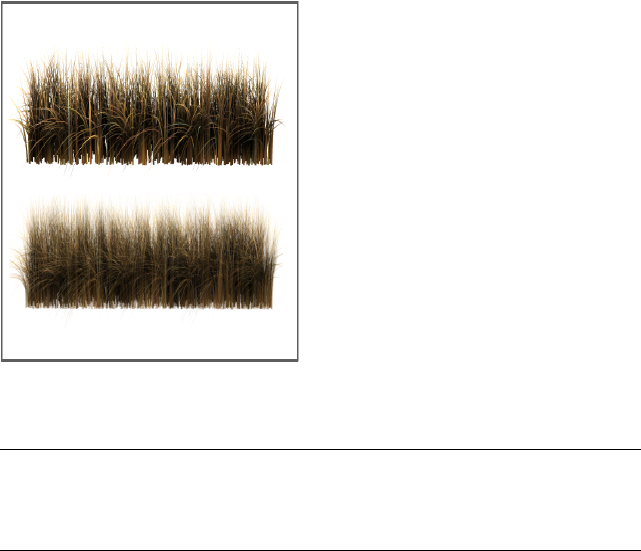
Hair Passes Sets the number of transparency passes. Default=1. Range=1 to
20.
Hair's buffer render on page 6388 has a fairly novel way of handling hair
transparency. Instead of resolving actual hair transparency, the hair is rendered
multiple times (as opaque hair) with different random seeds. These buffers
are then blended together. As you increase the Hair Passes value, the
transparency (or wispiness) of the hair increases. In addition, increasing the
value increases the actual number of rendered hairs as well, although the
apparent density, or fill, seems about the same because of the additional
transparency. Render time also increases linearly.
Top: Hair Passes=1
Bottom: Hair Passes=4
NOTE For best results when using the “mr prim” hair rendering method (see
Hair and Fur Render Effect on page 6386 ) with the mental ray renderer, be sure to
set the Trace Depth > Max. Depth value (see Rendering Algorithms Rollout (mental
ray Renderer) on page 6118 ) higher than the Hair Passes value.
Density The numeric value sets the overall hair density; that is, it acts as a
percentage multiplier of the Hair Count value. Default=100.0. Range=0.0 to
100.0.
This attribute is also mappable via the map button to the right of the spinner.
Mapping lets you add a texture map to control the amount of hair. An area
of the map whose gray value is 50% will reduce the amount of hair grown in
Hair And Fur Modifier | 1087
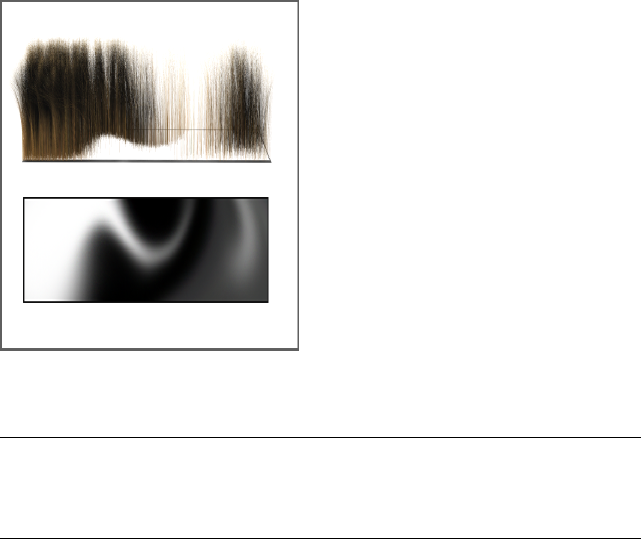
that area by 50%. To change the overall hair count, use the Hair Count value
(see above).
Top: Density=100.0 + map
Bottom: The bitmap used to control density
TIP For optimal efficiency, use the Hair Count value to set the actual number of
hairs, leave Density at 100.0, and use mapping to create uneven hair distribution.
Simply lowering the Density value without specifying a map causes hairs to be
created and then discarded, which unnecessarily increases rendering time.
Scale Sets the overall scaling for the hairs. Default=100.0. Range=0.0 to 100.0.
At the default value of 100.0, the hairs are full size. Reduce this value to make
the hairs smaller. To make the hairs larger, use the styling tools on page 1070
. Default=100.0. Range=0.0 to 100.0.
This attribute is also mappable via the map button to the right of the spinner.
Mapping allows you to add a texture map to control the length of the hair.
An area of the map whose gray value is 50% will cut the hair grown in that
area to 50% of its original length, with no shape change.
1088 | Chapter 9 Modifiers
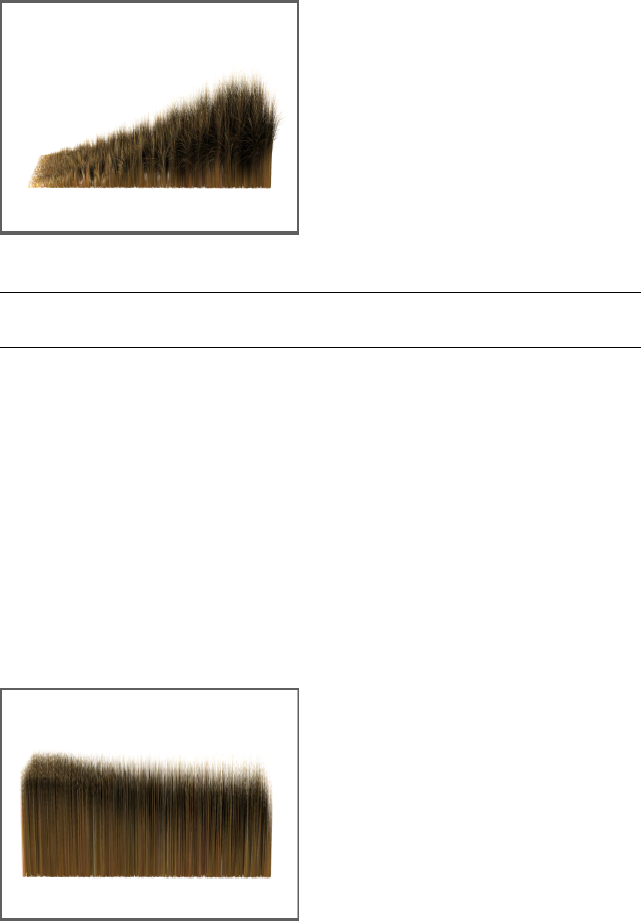
Scale value ramped from 0.0 (left) to 100.0 (right) using a linear gradient map
NOTE The default size of the hairs depends on the size of the object to which the
modifier is applied. The larger the object, the greater the initial size.
Cut Length The numeric value sets the overall hair length as a percentage
multiplier of the Scale value. Default=100.0. Range=0.0 to 100.0.
This attribute is also mappable via the map button to the right of the spinner.
Mapping allows you to add a texture map to control the length of the hair.
An area of the map whose gray value is 50% will cut the hair grown in that
area to 50% of its original length, with no shape change.
This parameter is more computationally expensive than a density map, since
each curve is re-parameterized on the fly, and should not be confused with a
density map. It’s really more useful as an animated effect for growing hair (for
example, creating a wolfman character).
Rand. Scale Introduces random scaling into the rendered hairs. Default=40.0.
Range=0.0 to 100.0.
Random Scale value ramped from 0.0 (left) to 100.0 (right) using a linear gradient map
Hair And Fur Modifier | 1089
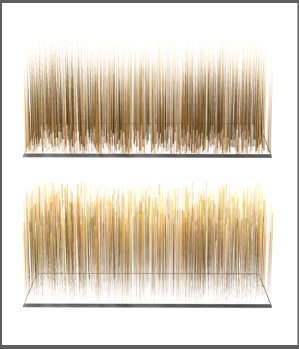
At the default value of 40.0, 40 percent of the hairs are scaled down randomly
by varying amounts. At 0.0, no random scaling is introduced.
Root Thick Controls the thickness of the hair at its root. With instanced
hair, this controls the overall thickness as a multiplier of the original object's
dimensions on the X and Y axes in object space.
This setting affects both native hair and instanced hair. With instanced hair,
Root thick controls the overall thickness of the hair, not just at the root.
Tip Thick Controls the thickness of the hair at its tip.
This setting affects native hair only, not instanced hair. To create tapering in
instanced hair, apply the tapering when modeling the object to be instanced
within Hair.
Top: Root Thick=10.0, Tip Thick=0.0
Bottom: Tip Thick=10.0, Root Thick=0.0
Hair is translucent if its width is less than one pixel. Thin hair that rendered
as opaque in previous versions of the software might give unexpected results
when rendered in this version. On the other hand, setting Root Thick and Tip
Thick to small values (close to or less than 1.0) can be a good way to obtain
translucent hair.
Displacement Displaces the hair roots from the surface of the growth object.
Default=0.0. Range=–999999.0 to 999999.0.
When you render an object with a high polygon count, but use a low-polygon
proxy object to grow the hair, adjusting Displacement can help make the hair
seem to grow from the high-polygon object, rather than floating above it.
1090 | Chapter 9 Modifiers

Another use for this setting can be animating the hair falling onto or moving
away from the growth object.
Interpolate When on, hair growth is interpolated among the guide hairs,
and the surface is fully populated with hair according to the General Parameters
settings. When off, Hair generates only one hair per triangular face on the
growth object, up to the limit imposed by the Hair Count setting. Default=on.
Material Parameters Rollout (Hair and Fur)
Select an object with the Hair And Fur modifier applied. > Modify panel >
Material Parameters rollout
The parameters on this rollout apply to buffer-rendered hair on page 6388
generated by Hair. In the case of geometry-rendered hair on page 6388 , the
hair coloring is derived from the growth object. In the case of hair rendered
by “mr prim”, all parameters apply except Self Shadow and Geom. Shadow.
With instanced hair, Hair uses the material from the instanced object.
You can apply a map to any value by clicking the blank button to the right
of the parameter. Values in the map act as multipliers to the base value.
TIP If you apply a colored texture map to a color attribute such as Tip Color, start
by setting the base color to white. Because the map acts as a multiplier, not doing
so can lead to unexpected results. For example, if Tip Color is set to yellow and
you apply a blue texture map, the hair will be black: this is because if you multiply
those RGB values, they zero each other out.
Hair And Fur Modifier | 1091
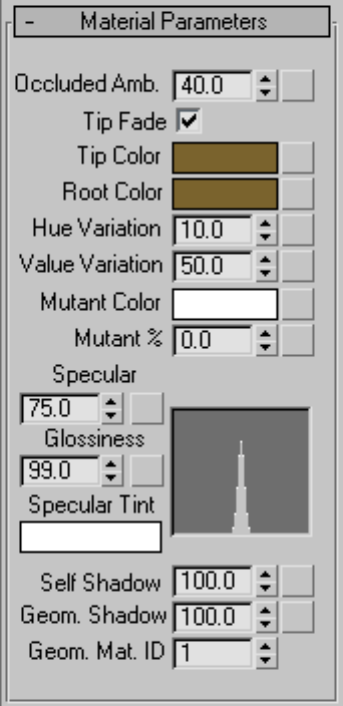
Interface
Occluded Amb. Controls the bias of the ambient/diffuse contributions of
the illumination model. A setting of 100.0 renders the hair with flat lighting.
A value of 0.0 is lit only by scene light sources, typically resulting in a
higher-contrast solution. Default=40.0. Range=0.0 to 100.0.
1092 | Chapter 9 Modifiers
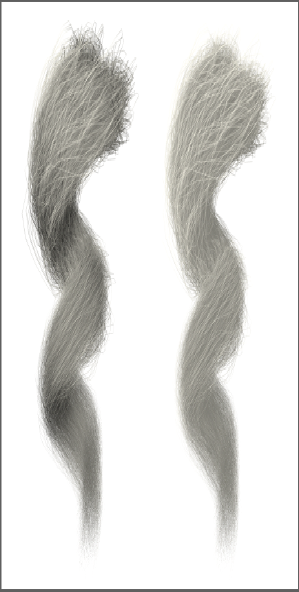
Left: Occluded Amb=0.0
Right: Occluded Amb=100.0
Both: Color=white, Self Shadow=50.0
Tip Fade Applies only to mr prim on page 6388 rendering (with the mental
ray renderer). When on, the hair fades to transparent toward its tip. When
off, the hair is equally opaque for its entire length.
Tip Color Hair color at the tips, farthest from the growth object surface. To
change the color, click the color swatch and use the Color Selector.
Root Color Hair color at the roots, closest to the growth object surface. To
change the color, click the color swatch and use the Color Selector.
Hair And Fur Modifier | 1093
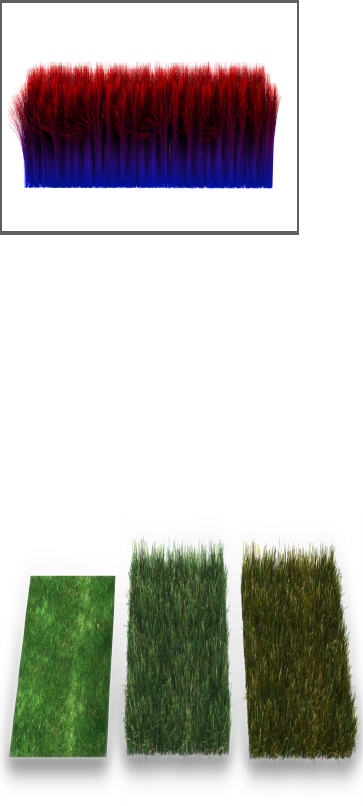
Tip Color=red
Root Color=blue
Hue Variation=0.0
The Tip Color and Root Color attributes are also mappable via the map buttons
to the right of the spinners. These let you add texture maps to control the
hair coloring, separately at the tip and base. The UVW mapping used for the
texture is the same as that of the growth object.
For results closest to the map colors, set Tip Color and Root Color to white.
Alternatively, set a different color to tint the map coloring.
Left: The texture map used for the hair (center and right)
Center: The map applied to Tip Color and Root Color causes the hair to use the same
coloring.
Right: Setting Tip Color and Root Color to orange adds an orange tint to the hair.
Hue Variation The amount by which Hair varies the color of the hairs. The
default value results in natural-looking hair. Default=10.0. Range=0.0 to 100.0.
1094 | Chapter 9 Modifiers
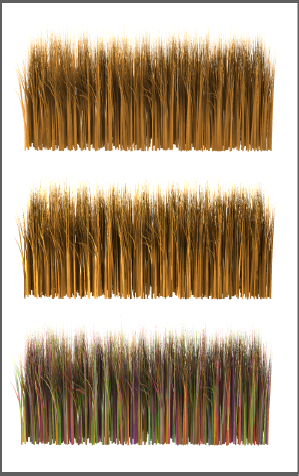
Value Variation The amount by which Hair varies the brightness of the hairs.
The default value results in natural-looking hair. Default=50.0. Range=0.0 to
100.0.
Top: Hue/Value Variation=0.0
Middle: Value Variation=100.0
Bottom: Hue Variation=100.0
Mutant Color The color for mutant hairs. Mutant hairs are randomly selected,
based on the Mutant % value (see following), and receive this color.
One example of mutant hairs are the gray hairs that appear as we age.
Mutant % The percentage of hairs that receive the mutant color (see above).
You can animate the Mutant % value to produce, for example, a rapidly aging
character. Default=0.0. Range=0.0 to 100.0.
Hair And Fur Modifier | 1095

Left: Mutant %=30.0
Right: Mutant %=0.0
Both: Color=brown, Mutant Color=white
Specular The brightness of highlights on the hairs.
Glossiness The relative size of highlights on the hairs. Smaller highlights
result in glossier-looking hair.
The combined results of the Specular and Glossiness settings appear in a graph
to the right of the two parameters.
Left: Specular=0.0, Glossiness=0.0
1096 | Chapter 9 Modifiers
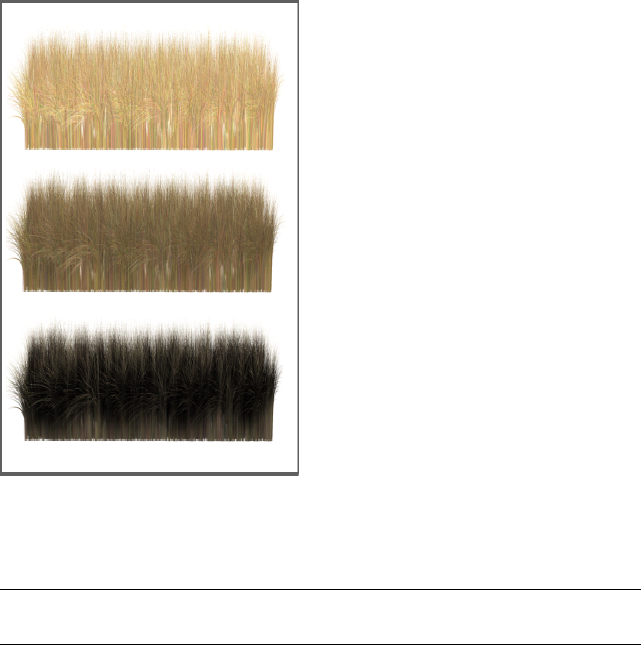
Center: Specular=100.0, Glossiness=75.0
Right: Specular=100.0, Glossiness=0.1
Specular Tint This color tints specular highlights. Click the color swatch to
use the Color Selector. Default=white.
Self Shadow Controls the amount of self-shadowing; that is, hairs casting
shadows on other hairs within the same Hair And Fur modifier. A value of 0.0
disables self shadowing, while a value of 100.0 results in maximum
self-shadowing. Default=100.0. Range=0.0 to 100.0.
Top: Self Shadow=0.0
Center: Self Shadow=50.0
Bottom: Self Shadow=100.0
NOTE You can adjust the shadow characteristics by changing the Hair Light Attr
rollout on page 5076 settings for lights that illuminate the hair.
Geom. Shadow The amount of shadow contribution hair receives from
geometry in the scene. Default=100.0. Range=0.0 to 100.0.
Geom. Mat. ID The material ID assigned to geometry-rendered hair on page
6388 . Default=1.
Hair And Fur Modifier | 1097
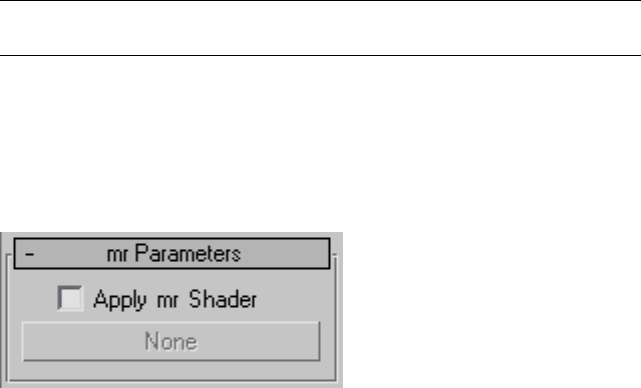
mr Parameters Rollout (Hair and Fur)
Select an object with the Hair And Fur modifier applied. > Modify panel > mr
Parameters rollout
Lets you assign a mental ray shader on page 5801 to generate hair. 3ds Max
passes the object's UV coordinate data, including map channels, to the mental
ray shader; strictly speaking, the shader generates hair from this UV and
mapping data, not from the object geometry itself. (Multiple map channels
are supported.)
When you use a mental ray shader for hair, you must render your scene using
the mental ray renderer on page 6039 and set the Hair And Fur render effect
on page 6386 method to “mr prim”.
IMPORTANT When you assign a mental ray shader, only the shader's own controls
apply to the generated hair. All other Hair And Fur settings are disregarded.
Aside from the “mr prim” option that you can choose as a render effect (see
Hair and Fur Render Effect on page 6386 ), no mental ray hair shaders are
provided with 3ds Max. This feature is meant to support third-party hair shader
products or custom-coded hair shaders.
Interface
Apply mr Shader When on, lets you apply a mental ray shader to generate
hair.
[shader button] Enabled only when “Apply mr Shader” is on. Click to display
a Material/Map Browser on page 5194 and assign the shader.
When no shader is assigned, this button is labeled “None”. When a shader is
assigned, the button's label shows the shader's name.
1098 | Chapter 9 Modifiers
Frizz Parameters Rollout (Hair and Fur)
Select an object with the Hair And Fur modifier applied. > Modify panel >
Frizz Parameters rollout
Frizz displacement is accomplished by doing a Perlin noise lookup at the hair's
rest position root, and then displacing the hair much the way bump mapping
displaces a surface normal. The frequency of the noise function is set by the
Frizz X/Y/Z Frequency parameters. The magnitude of the displacement is
controlled with Frizz Root and Frizz Tip. If you set dynamics mode on page
1113 to Live, the viewports show the effects of changing these settings in real
time.
Hair And Fur Modifier | 1099
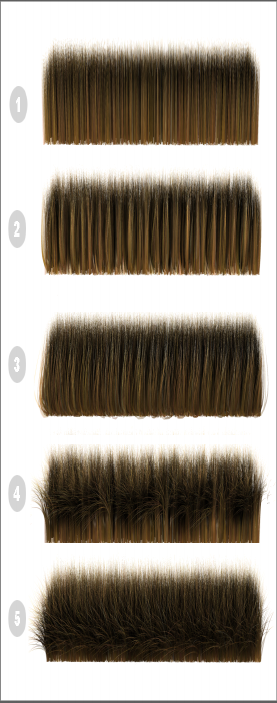
1. Frizz Root/Tip=0.0
2. Frizz Root=50.0, Frizz X/Y/Z Freq=14.0
3. Frizz Root=150.0, Frizz X/Y/Z Freq=60.0
4. Frizz Tip=30.0, Frizz X/Y/Z Freq=14.0
5. Frizz Root=50.0, Frizz Root=100.0, Frizz X/Y/Z Freq=60.0
Frizz actually calculates two noise fields, both of which use the same frequency
settings and tip/root amplitudes. One of the noise fields is static relative to
the hair. The Anim parameters let you animate the second noise field through
the hair over time. This is useful for things like grassy fields, where it would
1100 | Chapter 9 Modifiers
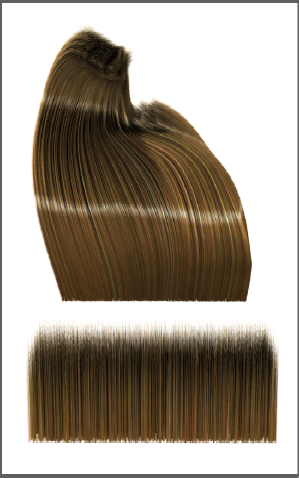
be overkill to compute real dynamics. These parameters give you a similar
result, at a small fraction of the computational overhead.
All Frizz/Kink settings=0.0; this reference image provided for comparison with the Frizz
and Kink illustrations (below).
Hair And Fur Modifier | 1101
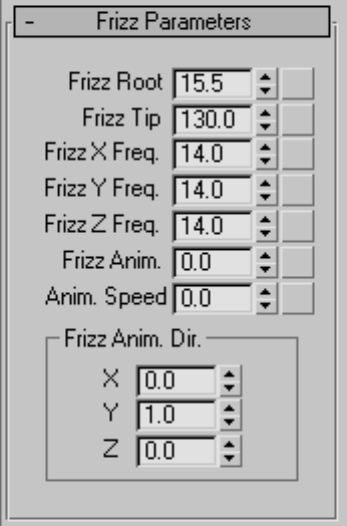
Interface
Frizz Root Controls the displacement of the hair at its root. Default=15.5.
Range=0.0 to 360.0.
Frizz Tip Controls the displacement of the hair at its tip. Default=130.0.
Range=0.0 to 360.0.
1102 | Chapter 9 Modifiers
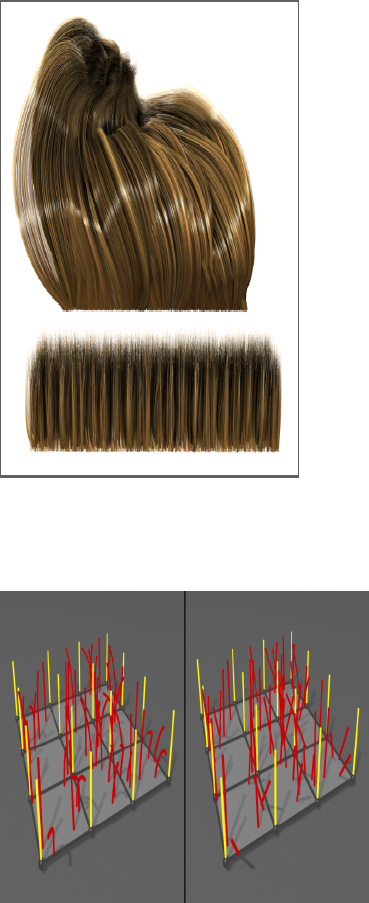
Frizz Root=30.0, Frizz Tip=100.0, Frizz X/Y/Z Freq=14.0
Top: Styled
Bottom: Unstyled
Left: Differing values for Frizz Root and Frizz Tip result in curved hairs.
Right: When Frizz Root=Frizz Tip, the hairs are straight.
Hair And Fur Modifier | 1103
Frizz X/Y/Z Freq(uency) Controls the frequency of the frizz effect on each
of the three axes. Default=14.0. Range=0.0 to 100.0.
Like frizz, Frizz Anim displaces the hair with a noise field. The difference is
that you can move the noise field to create animated displacement, resulting
in wavy movement without having to resort to dynamics.
Frizz Anim. Sets the amplitude of the wavy motion. Default=0.0.
Range=–9999.0 to 9999.0.
Anim. Speed This multiplier controls the speed at which the animating noise
field moves through space. This value is multiplied by the X, Y, and Z
components of the Frizz Anim Dir attribute to determine the per-frame offset
of the animating noise field. Default=0.0. Range=-9999.0 to 9999.0.
Frizz X/Y/Z Anim. Dir(ection) Sets the direction vector of the frizz animation.
Default=0.0. Range=–1.0 to 1.0.
This vector is not normalized before use. This means that you can apply small
tweaks to the values to achieve fine control over the speed of the animation
on a given axis. To reduce confusion it’s a good idea to keep these directions
either –1, 0, or 1. Once you’ve got the animation close to what you want, you
can diverge from these and adjust the values to achieve the exact result you
need.
Kink Parameters Rollout (Hair and Fur)
Select an object with the Hair And Fur modifier applied. > Modify panel >
Kink Parameters rollout
Kink displacement works similarly to Frizz, but evaluates noise lookups along
the whole length of the guide. The result is a noise pattern that works on a
larger scale than the Frizz noise. The effect is similar to crimped hair.
1104 | Chapter 9 Modifiers
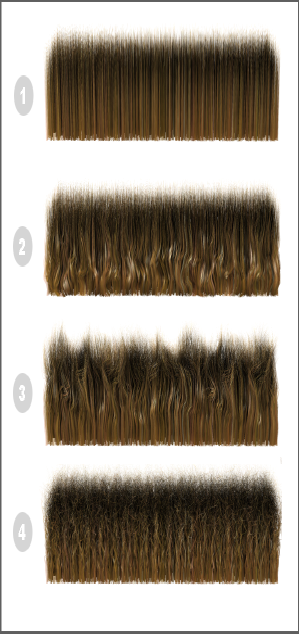
1. All settings=0.0 (no kink)
2. Kink Root=0.5 (rest=0.0)
3. Kink Tip=10.0, Kink Root=0.0, Kink X/Y/Z Freq=4.0,
4. Kink Tip=10.0, Kink Root=0.0, Kink X/Y/Z Freq=50.0,
Hair And Fur Modifier | 1105
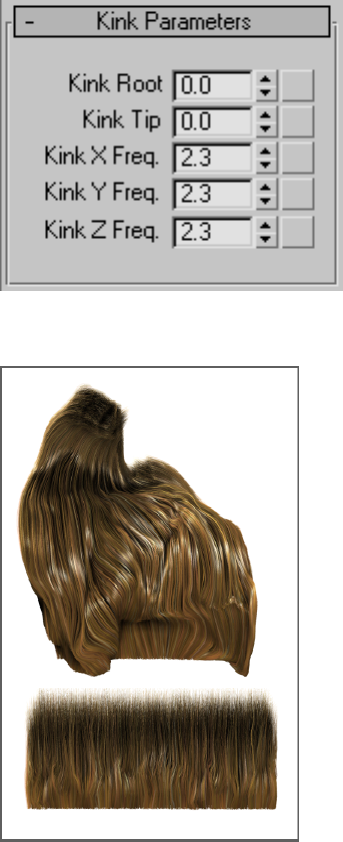
Interface
Kink Root Controls the amount of kink displacement of the hair at its root.
Default=0.0. Range=0.0 to 100.0
Kink Root=0.5, Kink Tip=0.0, Kink X/Y/Z Freq=4.0
Top: Styled
Bottom: Unstyled
1106 | Chapter 9 Modifiers
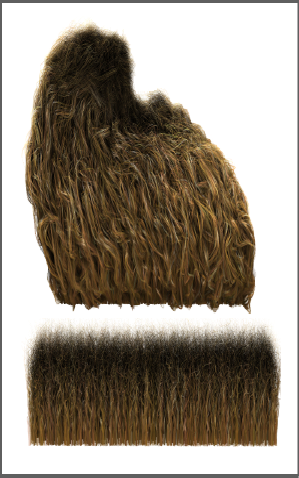
Kink Tip Controls the amount of kink displacement of the hair at its tip.
Default=0.0. Range=0.0 to 100.0
Top: Styled, Kink Tip=10.0, Kink Root=0.5, Kink X/Y/Z Freq=50.0
Bottom: Unstyled, Kink Tip=10.0, Kink Root=0.0, Kink X/Y/Z Freq=50.0
Kink X/Y/Z Freq(uency) Controls the frequency of the kink effect on each
of the three axes. Default=0.0. Range=0.0 to 100.0.
Multi Strand Parameters Rollout (Hair and Fur)
Select an object with the Hair And Fur modifier applied. > Modify panel >
Multi Strand Parameters rollout
Some degree of clumping gets naturally created when you use Frizz at low
frequencies, but you can go a bit further here with the Multi Strand parameters.
For each hair that is normally rendered, Multi Strand renders a clump of
additional hairs scattered around the original hair. The Splay settings control
the degree of scattering at the roots and tips, and Multi Strand Count controls
the number of hairs to create for the clump. You can use Splay to shape the
clump by spreading or compressing the roots and tips.
Hair And Fur Modifier | 1107
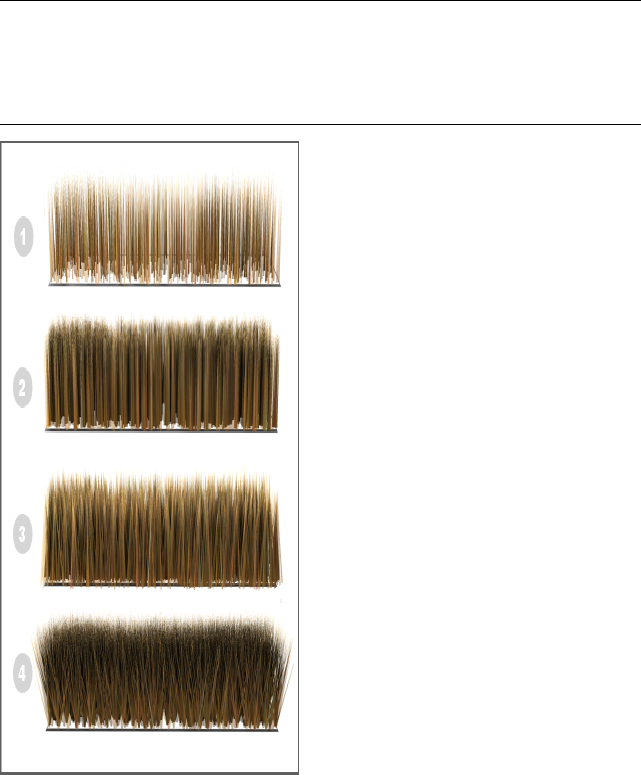
TIP For each original hair, Multi Strand creates a cluster of hairs around that hair,
offset at the bottom by the Root Splay factor. The hair is offset in the plane tangent
to the root of the hair, which is not necessarily the surface of the object. To make
sure Multi Strand hairs actually make contact with the surface, make the growth
surface a bit smaller than the rendered surface.
1. Multi Strand Count=0, Hair Count=500
2. Multi Strand Count=10, Root Splay=0.1, Tip Splay=0.1, Hair Count=500
3. Multi Strand Count=10, Root Splay=0.4, Tip Splay=0.1, Hair Count=500
4. Multi Strand Count=10, Root Splay=0.0, Tip Splay=1.0, Hair Count=500
1108 | Chapter 9 Modifiers
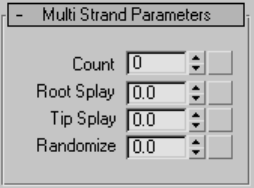
Interface
Count The number of hairs per clump.
Root Splay Provides a random offset for each hair in a clump, at the root.
Tip Splay Provides a random offset for each hair in a clump, at the tip.
Randomize Randomizes the size of each hair in a clump.
Dynamics Rollout (Hair and Fur)
Select an object with the Hair And Fur modifier applied. > Modify panel >
Dynamics rollout
For hair to seem natural in an animation, it must respond to the motion of
the body it's attached to and to external influences such as wind and gravity.
Hair's Dynamics functions let the hair behave like real-world hair, in interactive
(Live) or Precomputed mode.
Designating Collision Surfaces
Hair dynamics uses guide hairs to calculate collision. To reduce computation,
you have to explicitly designate the objects with which hair will collide. The
object from which the hair grows is a special case: to have hair collide with
this object (for example, a human head), simply turn on Use Growth Object.
If there is a collision object that you want more than one Hair modifier to
interact with, you have to add that object as a collision object for each different
Hair And Fur modifier.
There are two different methods for calculating collision: Sphere and Polygon.
Spherical collision uses a bounding sphere for collision objects; polygonal
collision uses the collision object's actual geometry. The Polygon option is
more accurate, but the Sphere option is quicker to calculate.
Hair And Fur Modifier | 1109

Procedures
Example: To view hair dynamics in real time:
1Apply the Hair And Fur modifier to an object.
2On the Dynamics rollout (scroll the command panel down to view it),
set Mode to Live.
3Move the object around.
The hair moves realistically.
4On the Tools rollout, click Regrow Hair.
The hair resumes its default position, growing straight out of the object.
5 Click the Play Animation button.
6The hair settles and droops, as if affected by gravity. Note that, as the
animation repeats, the effects of gravity are cumulative; the hair animation
doesn't restart at the first frame.
7On the Tools rollout, click Regrow Hair again.
8Add a Wind space warp to the scene.
9On the Dynamics rollout, set Dynamics Params > Gravity to 0.0.
10 In the External Forces group (at the bottom of the Dynamics rollout),
click Add and then select the Wind space warp.
11 Play the animation again.
This time, the hair isn't affected by gravity, but simply blown by the
wind. Again, the effect is cumulative and the animation doesn't repeat.
All of this animation takes place only in real time; no keyframes are set,
so it can't be rendered. To learn how to set up a renderable dynamics
simulation with Hair, see the following procedure.
To generate a precomputed dynamics simulation with Hair:
1Apply the Hair And Fur modifier to an object.
2Set up the animation. It could simply be motion of the growth object,
or you could use the Dynamics rollout > External Forces group to add
space warps, such as Wind, that should affect the hair. Actually, because
the hair is affected by its own gravity by default, you don't need to set
up any explicit animation at all to see hair dynamics.
1110 | Chapter 9 Modifiers
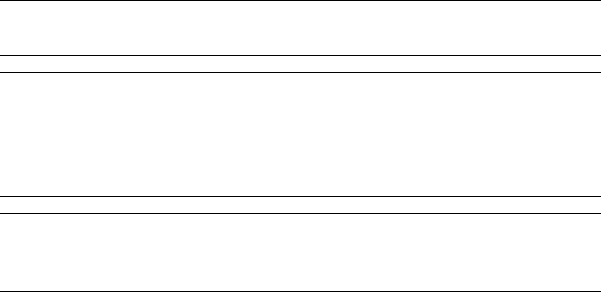
3On the Modify panel > Dynamics rollout, use the Collisions group to set
objects the hair should collide with. Also set other simulation parameters
in the Dynamics Params group.
4In the Stat Files group, click the ellipsis (...) button. Use the Save As dialog
to specify the location and name of the stat files to be generated.
NOTE When you run the simulation, Hair will generate a separate stat file
for each animation frame.
IMPORTANT If you plan to render the animation with a networked render
farm, make sure the path you specify can be seen in exactly the same way
from each node on the render farm. If stat files aren’t found, hair will be stiff
and just oriented to the skin as it moves. If the wrong stat files are found, hair
can float right off an object.
TIP If using Windows XP, click the My Network Places button to set a path
using the Universal Naming Convention (UNC), even if it's on a local drive.
Such a path can be accessed readily by other computers on the network.
The path and stat file name appear in the text field next to the ellipsis
button.
5In the Simulation group, set the frame range for the simulation and then
click Run.
Hair runs the dynamics simulation and generates a stat file for each frame
in the animation. It also automatically sets the mode to Precomputed,
so when you play or render the animation, it reads the stat files and uses
the information for the hair positioning in each frame.
6Play the animation.
The dynamics simulation stored in the stat files appears in the viewports.
7In the Mode group, choose None, and then play the animation again.
The dynamics animation no longer appears. However, it's still stored in
the stat files, and will reappear if you choose Precomputed.
8Make sure Precomputed is on, and then render the animation.
Hair And Fur Modifier | 1111

Interface
1112 | Chapter 9 Modifiers
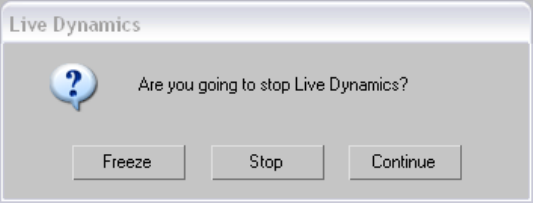
Mode group
Chooses the method Hair uses to generate dynamics. Live mode is suitable
for experimentation, but for best results when rendering animation with Hair,
use Precomputed mode.
■None Hair doesn't simulate dynamics.
■Live Hair simulates dynamics interactively in the viewports, but doesn't
generate animation keyframes or stat files for the dynamics. For best results
with Live mode, turn off Display rollout > Display Hairs group > As
Geometry.
For some methods of using live dynamics, see this procedure: Example:
To view hair dynamics in real time: on page 1110 .
If you press ESC while using live dynamics, 3ds Max displays a dialog that
asks whether you want to stop live dynamics. Both Freeze and Stop reset
the mode to None, but Freeze freezes the hair in its current position. You
can use this as a starting point for precomputed dynamics, or as a point
from which you style the hair.
■Precomputed Lets you generate stat files for rendering dynamics-animated
hair. Available only after setting a name and location for stat files (see
following and To generate a precomputed dynamics simulation with Hair:
on page 1110 ).
Stat Files group
Stat files let you record and play back a Hair-generated dynamics simulation.
For a workflow example, see this procedure: To generate a precomputed
dynamics simulation with Hair: on page 1110 .
Text field Displays the path and file name for the stat files.
... (ellipsis) button Click to choose a name prefix and location for stat files
using the Save As dialog.
Hair And Fur Modifier | 1113
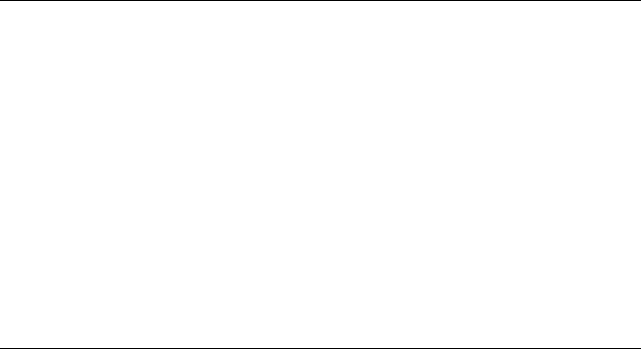
Hair adds a four-digit frame number (with leading zeroes) and the file name
extension “.stat” to the name you provide (for example, hair_test0001.stat).
Delete all files Deletes stat files from the target directory. The files must have
the name prefix you assigned using the ... button.
TIP You can still use stat files even if you move them to another location. Follow
this procedure:
1Open the MAX file used to generate the stat files.
2On the Modify panel > Dynamics rollout, click the ... [ellipsis] button.
3Use the Save As dialog to navigate to the directory with the stat files, and
then click any stat file. Its name appears in the File Name field.
4Edit the File Name field to delete the four-digit extension after the stat
file name. For example, if the stat file name is test0033.stat , delete the
“0033” so that it reads test.stat .
5Click the Save button. The new stat file path appears in the Stat Files
field.
Now, when you play or render the animation, Hair uses the stat files as
originally generated.
Simulation group
Determines the extent of the simulation, and lets you run it. These controls
become available only after you choose Precomputed mode and specify stat
files in the Stat Files group. Set Start and End to the frames at which to begin
and end the simulation, and then click the Run button. The software then
computes the dynamics and saves the stat files.
Start The first frame to consider in calculating the simulation.
End The final frame to consider in calculating the simulation.
Run Click to run the simulation and generate the stat files within the frame
range indicated by Start and End.
To abort a simulation while it's running, click Cancel on the status bar.
Dynamics Params group
These controls specify the basic parameters for the dynamics simulation. The
Stiffness, Root Hold, and Dampen values can be mapped: click the map button
1114 | Chapter 9 Modifiers
to the right of the spinner to assign a map. Grayscale values in the map
multiply the parameter's value at that hair location.
Gravity Lets you specify a force that moves hair vertically in world space.
Negative values pull hair up while positive values pull it down. To cause hair
not to be affected by gravity, set the value to 0.0. Default=1.0. Range=–999.0
to 999.0.
Stiffness Controls the magnitude of the effect of dynamics. If you set Stiffness
to 1.0, the dynamics will have no effect. Default=0.4. Range=0.0 to 1.0.
Root Hold Comparable to stiffness, but affects the hair only at the roots.
Default=1.0. Range=0.0 to 1.0.
Dampen Dynamic hair carries velocity forward to the next frame. Increasing
dampening increases the amount by which these velocities are diminished.
Thus, a higher Dampen value means that hair dynamics will be less active
(the hair can also start to get “floaty”). Default=0.0. Range=0.0 to 1.0.
Collisions group
Use these settings to determine which objects hair collides with during a
dynamic simulation and the method by which collision is calculated.
■None Collisions are not considered during the dynamic simulation. This
can cause the hair to penetrate its growth object as well as other objects it
comes into contact with.
■Sphere Hair uses a spherical bounding box to calculate collisions. This
method is faster because it requires less computation, but can cause
inaccurate results. It's most effective when the hair is seen from a distance.
■Polygon Hair considers each polygon in the collision objects. This is the
slowest method, but the most accurate.
Use Growth Object When on, hair collides with the growth (mesh) object.
Objects list Lists the names of scene objects with which hair should collide.
Add To add an object to the list, click Add and then click the object in a
viewport.
Replace To replace an object, highlight its name in the list, click Replace,
then click a different object in a viewport.
Delete To remove an object, highlight its name in the list, then click Delete.
Hair And Fur Modifier | 1115

External Forces group
This group lets you specify space warps on page 2603 that will affect the hair
during the dynamics simulation. For example, you can add a Wind space
warp on page 2642 to cause the hair to be blown by a breeze.
NOTE Hair dynamics already has a built-in gravity force, so it's not necessary to
add one.
Objects list Lists the names of forces that dynamically affect the hair.
Add To add a space warp to the list, click Add and then click the warp's icon
in a viewport.
Replace To replace a space warp, highlight its name in the list, click Replace,
then click a different warp's icon in a viewport.
Delete To remove a space warp, highlight its name in the list, then click
Delete.
Display Rollout (Hair and Fur)
Select an object with the Hair And Fur modifier applied. > Modify panel >
Display rollout
These settings let you control how hairs and guides display in the viewports.
By default, Hair displays a small percentage of the hairs as lines. Alternatively,
you can display the hairs as geometry, and you can also choose to display the
guides.
1116 | Chapter 9 Modifiers
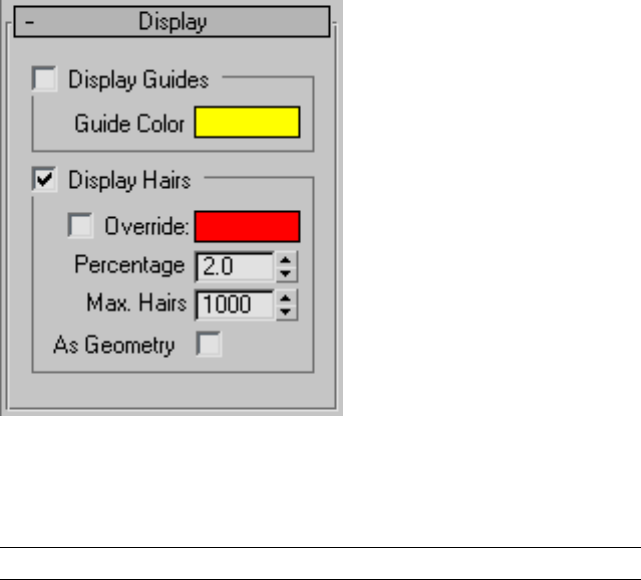
Interface
Display Guides group
Display Guides toggle When on, Hair displays guides in the viewports, using
the color shown in the color swatch. Default=off.
NOTE At the Guides sub-object level, guides always appear in the viewports.
Guide Color Click to display the Color Selector and change the color used
to display guides.
Guides do not reflect some settings made to the hair, such as Frizz. Use the
Guides display mainly to see where hair will appear on the growth object.
Hair places one guide at each vertex on the growth surface.
Display Hairs group
Display Hairs toggle When on, Hair displays hairs in the viewports.
Default=on.
Override When off, 3ds Max displays hairs using an approximation of their
rendered color. When on, displays hairs using the color shown in the color
swatch. Default=off.
Hair And Fur Modifier | 1117

Color swatch Click to display the Color Selector and change the color used
to display hairs when Override is on.
NOTE When hair is displayed as geometry (see below), the color setting is ignored.
Percentage The percentage of total hairs displayed in the viewports. Lower
this value to improve real-time performance in the viewports.
Max. Hairs The maximum number of hairs displayed in the viewports,
regardless of the Percentage value.
As Geometry When on, displays the hairs in the viewports as the actual
geometry to be rendered, rather than the default lines. Default=off.
LS Colors Modifier (World Space)
Select a Lightscape mesh object. > Modify panel > Modifier List > World-Space
Modifiers > * LS Colors
The LS Colors modifier converts Lightscape radiosity values to 3ds Max vertex
colors.
When a Lightscape model is imported into 3ds Max, the radiosity values are
kept as irradiances; that is, they describe the intensity of light falling on a
mesh in physical units. This modifier converts the physical units to RGB colors.
In conjunction with the Lightscape mesh modifier, this modifier can be used
to produce meshes suitable for game engines.
1118 | Chapter 9 Modifiers
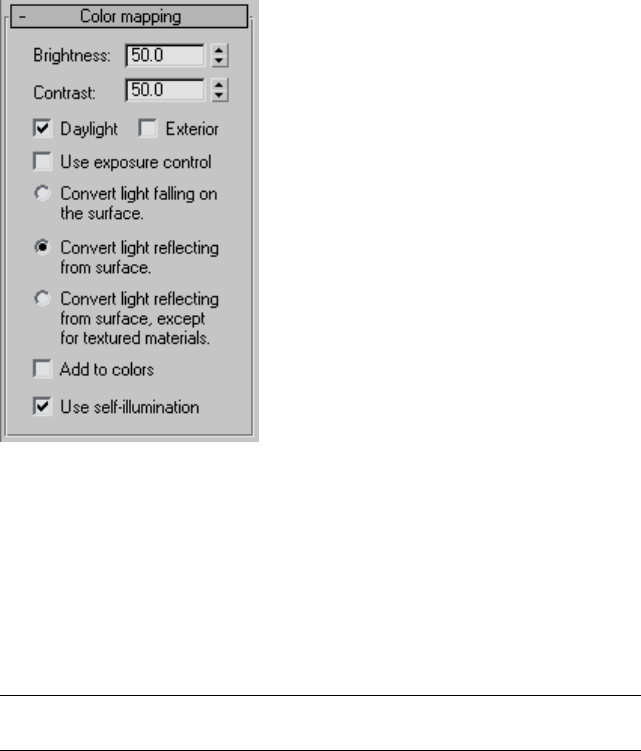
Interface
Brightness Controls the brightness of the displayed image on your monitor.
The setting of this control does not affect the actual lighting levels in the
model. Default=50.0.
Contrast box Controls the contrast between light and dark regions in the
model. Default=50.0.
Daylight Determines whether you want natural daylight to be used in the
calculation. Default=on.
Exterior Scene Turn on for exterior daylight simulations. Default=off.
TIP Use the logarithmic exposure control on page 6540 to control the brightness
and contrast of the colors when you render.
Use exposure control When on, disregards the settings of Brightness,
Contrast, Daylight, and Exterior, and instead uses the settings of the active
exposure control. If no exposure control is active in the scene, this toggle is
disabled. Default=off.
The three radio buttons that follow choose how to handle irradiance values.
■Convert light falling on the surface When chosen, converts the irradiance
values directly to RGB values. In order to properly render the mesh, the
LS Colors Modifier (World Space) | 1119
vertex colors need to be interpolated and multiplied by the color of the
material on the mesh.
■Convert light reflecting from the surface When chosen, takes the
irradiance values and multiplies them by the material's ambient color,
then converts the result to RGB. To properly render the mesh, you need
to interpolate the vertex colors over the faces. If textures are displayed by
multiplying them by the vertex colors, they will not be correctly displayed
unless the material color is white.
By default, this is the active option.
■Convert light reflecting from the surface, except for textured
materials When chosen, takes the irradiance values and multiplies them
by the material's ambient color, and then converts the result to RGB, unless
a texture is applied to the material's ambient component. If the ambient
component has a map, this method converts the irradiance value directly
to the vertex color. To properly render the mesh, you need to interpolate
the vertex colors over the faces, unless the material is textured. If textures
are displayed by multiplying them by the vertex colors, they will be
correctly displayed.
Add to colors When on, the result of the color conversion is added to existing
vertex color values, if there are any. Default=off.
Use self-illumination When on, the material's self illumination is included
in the final vertex colors. Default=on.
MapScaler Modifier (World Space)
Select an object. > Modify panel > Modifier List > World-Space Modifiers >
MapScaler (WSM)
Select an object. > Modifiers menu > UV Coordinates > Map Scaler (WSM)
MapScaler maintains the scale of a map applied to an object. This lets you
resize the object without altering the scale of the map. Typically, you might
use this to maintain the size of a map regardless of how the geometry is scaled.
1120 | Chapter 9 Modifiers
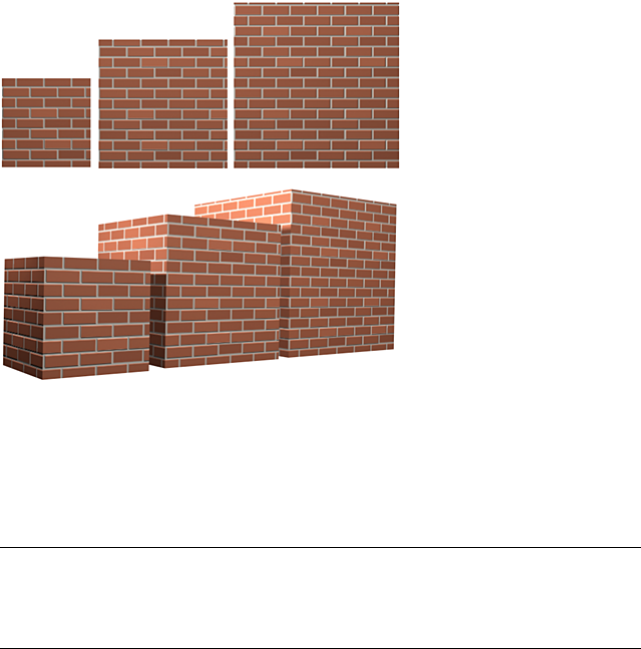
MapScaler sets the scale of a map on an object.
This differs from the MapScaler (OSM) modifier on page 1443 , which maintains
the scale of the map with respect to the object size when scaled with a Select
And Scale tool. See the latter's definition for other differences between the
two versions.
NOTE This world-space modifier is for use primarily with vertically oriented objects,
such as walls in an architectural model, or objects with large, flat surfaces. While
you can apply the MapScaler to any object, the results are less realistic on curved
surfaces, especially complex ones, which can show cracks in the finished texture.
MapScaler Modifier (World Space) | 1121
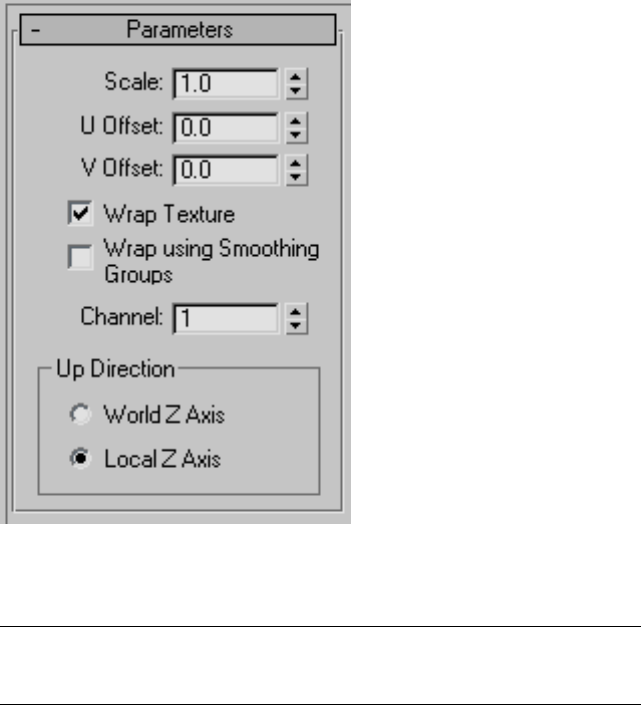
Interface
Scale Represents the size of one repetition of the texture pattern. Size is
measured in current system units. Repetitions occur across the object in the
U and V directions. Default=1.0.
NOTE When the Use Real-World Texture Coordinates switch is active in the
General Preferences dialog on page 7536 , the scale setting defaults to 1.0. If Use
Real-World Texture Coordinates is turned off, scale defaults to 100.0.
U/V Offset Specify horizontal and vertical offsets respectively. Available only
when Wrap Texture is off.
Wrap Texture When on, Map Scaler attempts to wrap the texture evenly
around the object. This option requires more computing, but usually produces
the most satisfactory results. Default=on.
Wrap Using Smoothing Groups When turned on, textures are wrapped
around corners when they share the same smoothing groups. Curved walls
will map smoothly while sharp corners get a new texture origin. This switch
is only available when the Wrap Textures switch is turned on. Default=off.
1122 | Chapter 9 Modifiers
Channel Specifies the map channel on page 7836 . Default=1.
Up Direction group
World Z Axis Aligns the map with the Z axis of the world.
If you choose this option and then rotate the object, the mapping is not fixed
to the object.
Local Z Axis Aligns the map with the local Z axis of the object.
With this option, the mapping remains fixed to the object.
PatchDeform Modifier (World Space)
Select an object. > Modify panel > Modifier List > World-Space Modifiers > *
PatchDeform
The PatchDeform world-space modifier lets you deform an object based on
the contours of a patch object. It works the same as the PathDeform (World
Space) on page 1123 , but uses a patch instead of a curve. With the exception
of the Move to Patch button, its parameters are the same as those in the
object-space PatchDeform modifier on page 1525 .
PathDeform Modifier (World Space)
Select an object. > Modify panel > Modifier List > Animation Modifiers > *
PathDeform
The PathDeform world-space modifier deforms an object based on a shape,
spline or NURBS curve path. With the exceptions noted in the Interface section,
this world-space modifier works the same as the object-space PathDeform
modifier on page 1528 .
Procedures
The first two examples, below, demonstrate the basic differences in orientation
and the relationship between the object and its path when using the
PathDeform modifier and the PathDeform (WSM) modifier.
PatchDeform Modifier (World Space) | 1123
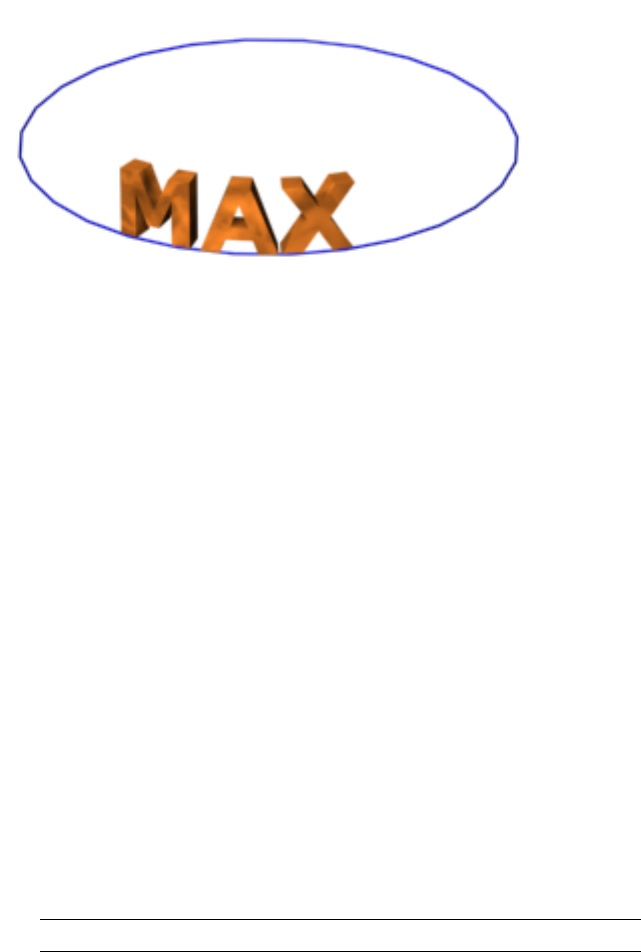
Example: To use the PathDeform modifier to curve text:
1In the Top viewport, create a circle that's 100 units in radius.
2In the Front viewport, create a text shape with six or seven letters, and a
size of 25.
3Apply an Extrude modifier to the text shape, and set the Amount to -5.0.
4On the Main toolbar, set the Reference Coordinate System to Local.
Looking at the axis tripod for the extruded text object, you can see that
its Z axis runs from back to front relative to world space.
5Apply a PathDeform on page 1528 object-space modifier to the text object.
Click the Pick Path button, and then select the circle.
A circular gizmo appears. The circle runs through the local Z axis of the
text object. Because of its orientation, its effect is minimal, but you can
see a slight wedge-shaped deformation from the top view.
6In the Path Deform Axis group, choose the Y option, and then the X
option.
The circle gizmo rotates to run through the specified axes, deforming the
text object differently with each change.
7Adjust the Percent spinner to view its effect, and then set it to zero. Try
the same with Stretch, Rotation, and Twist, and then restore them to
their original values.
TIP Use the Ctrl key with Twist to amplify the effect.
8Turn on Flip to switch the direction of the path, and then turn it off.
1124 | Chapter 9 Modifiers

9Go to the Gizmo sub-object level, and move the gizmo path around.
The text object is further deformed by its relative position to the gizmo.
10 Select the original circle shape, and change its radius.
The deformation of the text object alters because its gizmo is an instance
of the shape object.
Example: To use the PathDeform world space modifier:
This procedure continues from the previous one.
1Select the text object, and then remove the Path Deform modifier from
the stack.
2Apply a Path Deform (WSM) modifier.
3Click Pick Path, and select the circle.
The text object flips around and moves in world space. Note that its
orientation and deformation are difficult to analyze because there's an
offset distance between the path and the object.
4Click Move to Path.
The text object is transformed so that its local Z axis is aligned with the
path and its position is at the first vertex of the path.
In the following steps, you'll use various controls to re-orient the text
object so that it's at the front of the circle and readable from the Front
viewport.
5Choose the X option in the Path Deform Axis group to place the length
of the text object along the path.
6Adjust the Percent spinner to -25 to move the text to the front of the
circle.
7Adjust the Rotation spinner to -90 to rotate the text so it faces the Front
viewport.
8 Turn on Auto Key, go to frame 100, and set Percent to -125.
9Play the animation to watch the text run around the circle.
PathDeform Modifier (World Space) | 1125
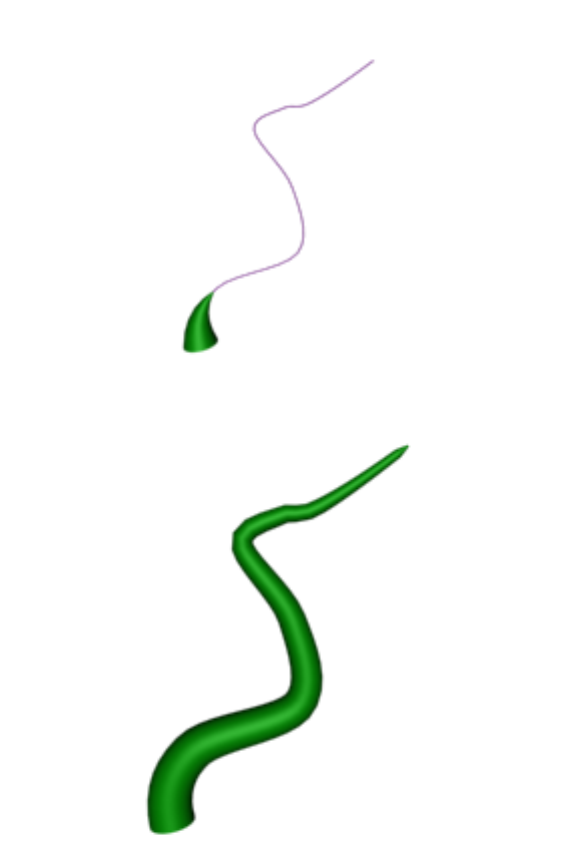
Example: To create a growing vine:
1Use the Line tool and, optionally, Editable Spline to create a path along
which the vine will grow.
2Create a Cone, and apply the * Path Deform modifier.
1126 | Chapter 9 Modifiers

3Pick the path, and then click Move to Path. (The local Z axis of the cone
should be along the path.)
4 Go to frame 100, and turn on Auto Key.
5Increase the Stretch value to stretch the cone along the path until it
reaches the end. There won't be enough height segments in the cone,
but you can fix that in step 7.
6 Turn off Auto Key.
7In the stack, click Cone, and then in the Parameters rollout increase the
Height Segments setting until the stretched cone is smooth on the path.
8Play the animation.
The cone grows along the path, like a vine.
Interface
Since this is a world-space rather than an object-space modifier, the object is
affected in world space coordinates, and also affected by the relative position
of the path to the object. Thus, if you transform the object relative to the
path, or vice-versa, it has an affect on the deformation.
Generally speaking, the Path Deform world-space modifier leaves the path in
place while moving the object to the path, while the Path Deform object-space
modifier leaves the object in place while moving the path to the object.
PathDeform Modifier (World Space) | 1127
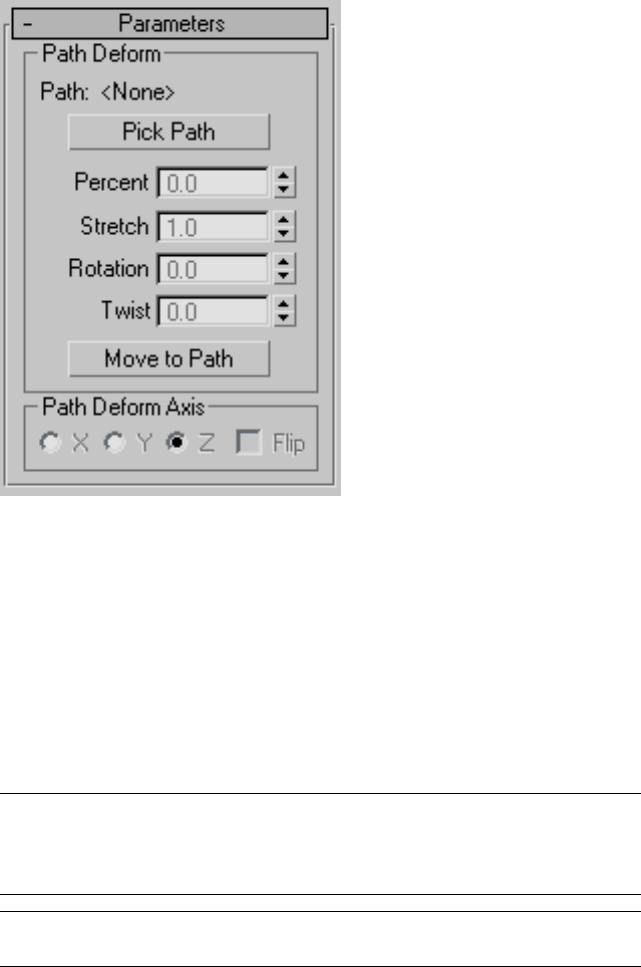
For all parameters except the following, refer to the PathDeform modifier on
page 1528 .
Path Deform group
Move to Path Moves the object from its original position to the start of the
path.
When you first pick a path, the object is deformed by the path based on the
offset distance between the first vertex in the path and the object's location.
Thus, as you adjust the Percent spinner, for example, the result will be distorted
depending on the offset distance.
IMPORTANT Using the Move To Path button applies a transform to the object
that's not removed if you later remove the Path Deform binding from the object.
However, you can undo on page 202 the transform immediately after it's been
performed.)
NOTE If the Auto Key button is on when you perform Move To Path, transform
keys are created.
1128 | Chapter 9 Modifiers
Point Cache Modifier (World Space)
Select an object. > Modify panel > Modifiers List > World–Space Modifiers >
* Point Cache
The world-space version of the Point Cache modifier works exactly the same
as the Point Cache modifier on page 1533 , except that it uses world-space
coordinates instead of local-space coordinates. Use this version when animating
with world-space modifiers such as PatchDeform (WSM) modifier on page
1123 or PathDeform (WSM) modifier on page 1123 .
Subdivide Modifier (World Space)
Make a selection. > Modify panel > Modifier List > World-Space Modifiers >
Subdivide
Make a selection. > Modifiers menu > Radiosity Modifiers > * Subdivide
The Subdivide (WSM) modifier is similar to the object-space Subdivide modifier
on page 1688 , and has the same parameters. In the world-space version of
Subdivide, the size limit is on the mesh after it is transformed into world space
coordinates.
Surface Mapper Modifier (World Space)
Make a selection. > Modify panel > Modifier List > World-Space Modifiers > *
Surface Mapper
The Surface Mapper (WSM) modifier takes a map assigned to a NURBS on
page 2152 surface and projects it onto the modified object or objects. Surface
Mapper is especially useful for seamlessly applying a single map to a group of
surface sub-objects within the same NURBS model. You can also use it for
other kinds of geometry.
The NURBS surface's map is projected onto the other geometry in the direction
of the NURBS surface's normals, or opposite the normals if the modified object
is on the other side of the NURBS surface.
Point Cache Modifier (World Space) | 1129
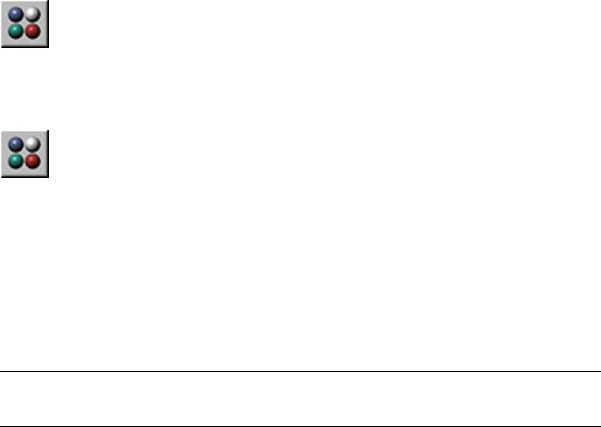
Procedures
To use the surface mapper world-space modifier:
1Create the NURBS surface to use for projection, and transform it so it
wraps the objects you want to map.
2 Use the Material Editor on page 5188 to assign a mapped material
to the NURBS surface.
3Select the objects you want to map.
4 Use the Material Editor to assign the same material to the objects
you want to map.
5Apply the Surface Mapper world-space modifier.
6In the Parameters rollout, turn on Pick NURBS Surface, and then click
the NURBS projection surface in a viewport.
The software now uses the NURBS surface's normals to project the texture
onto the modified objects.
TIP To fine-tune the map placement on the mesh, you can use the NURBS
surface's Edit Texture Surface dialog on page 2453 .
1130 | Chapter 9 Modifiers
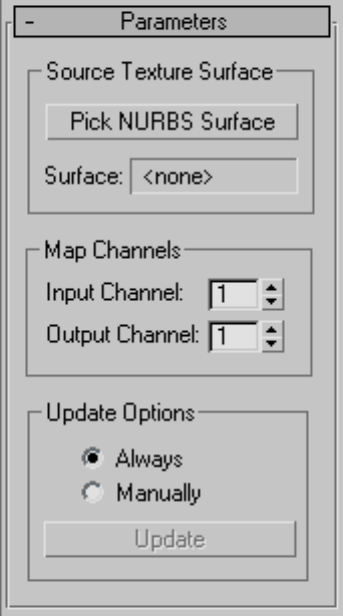
Interface
Source Texture Surface group
These controls let you choose the NURBS surface to project.
Pick NURBS Surface Picks the NURBS surface to use for projection. Click to
turn on this button, then click the NURBS surface in an active viewport.
Surface Shows "<none>" before you pick a NURBS surface; shows the name
of the surface after you pick one.
Map Channels group
These controls let you choose which map channels on page 7836 to use.
Surface Mapper Modifier (World Space) | 1131
Input Channel Selects the NURBS surface map channel to use before
projection.
Output Channel Selects the modified object's map channel to use after
projection.
Update Options group
These controls let you choose how to update the mapping displayed in
viewports. They have no effect if Show Map In Viewport on page 5254 is turned
off.
Always Updates viewports whenever the mapping changes.
Manually Updates viewports only when you click Update.
Update Updates viewports. This is unavailable unless you've chosen
Manually.
SurfDeform Modifier (World Space)
Select an object. > Modify panel > Modifier List > World-Space Modifiers > *
Surf Deform
Select an object. > Modifiers menu > Animation Modifiers > * Surf Deform
The SurfDeform (WSM) modifier works the same as the PathDeform (WSM)
modifier on page 1123 , except that it uses a NURBS Point or CV surface instead
of a curve.
Object-Space Modifiers
Object-space modifiers directly affect an object's geometry in local object
space on page 7868 .
When you apply an object-space modifier, it appears directly above the object
with other object-space modifiers in the modifier stack on page 7427 . The order
in which the modifiers appear in the stack can affect the resulting geometry.
For a list of object-space modifiers, see List of Available Modifiers on page 1011
.
1132 | Chapter 9 Modifiers

Affect Region Modifier
Modify panel > Make a vertex sub-object selection. > Modifier List >
Object-Space Modifiers > Affect Region
Make a vertex sub-object selection. > Modifiers menu > Parametric Deformers
> Affect Region
The Affect Region modifier is a surface modeling tool, primarily used with
vertex sub-object selections while surface modeling. With Affect Region,
transforming a selection of vertices can also transform vertices in the region
that surrounds the selection. This can help you form a bubble or indentation
in the surface of an object. The easiest way to see this modifier's effect is with
a shallow, flat box object with plenty of subdivisions. The Affect Region
modifier has a two-part, arrow-shaped gizmo plus numeric controls.
When you apply the Affect Region modifier, it assigns an arrow-like gizmo
consisting of two points connected by a line. The base of the arrow is the start
point. The length and direction of the arrow defines the amount of movement
of the vertices. Any vertices within Falloff distance of the base of the arrow
are translated in the direction of the arrow.
Because no points on the mesh are directly selected, this modifier doesn't
depend on the topology of the input object. You can apply it to any renderable
object. However, you can limit the effect by using a selection modifier like
Mesh Select on page 1455 or Volume Select on page 1910 to pass a sub-object
selection up the stack.
NOTE The Affect Region modifier is ideal for simple animated effects, especially
when you need to use interactive parameters. However, for fine-tuned modeling,
you'll probably prefer the expanded capabilities of Soft Selection on page 1926 in
Editable Mesh on page 1990 , Editable Poly on page 2038 , Edit Mesh on page 1283 ,
Mesh Select on page 1455 , Volume Select on page 1910 , the HSDS modifier on
page 1420 , and NURBS on page 2172 .
Affect Region Modifier | 1133
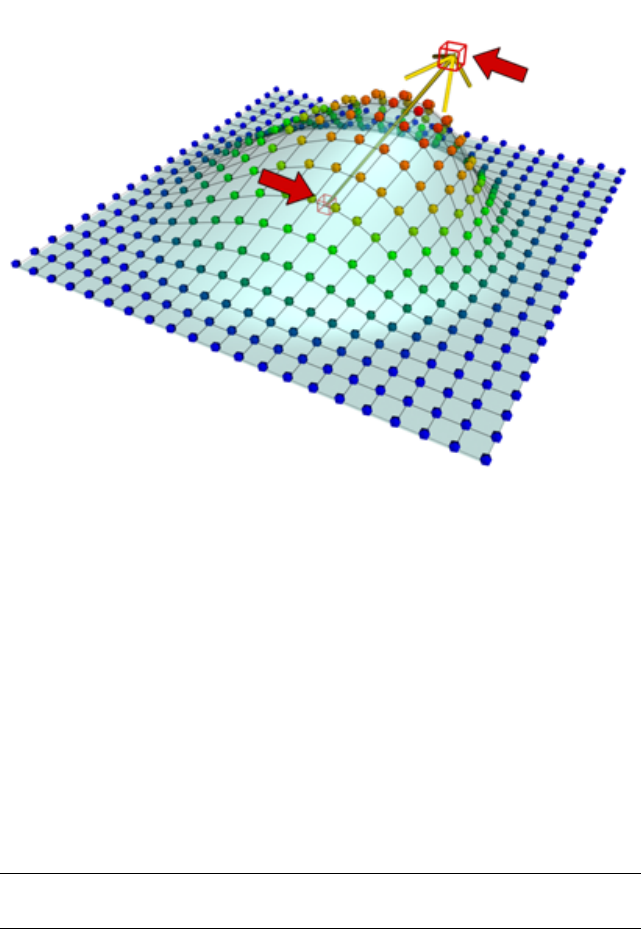
Affect Region modifier applied
Procedures
Example: To form a bubble over the surface of a plane:
1Create a plane with 15 width and length segments.
2Set the length and width of the plane to 50 units.
3Apply the Affect Region modifier.
4In the Parameters group, set Falloff to 50.
5Adjust the parameters to achieve different effects.
Interface
NOTE The parameters of this modifier are similar to those of the Soft Selection
function on page 1926 of an Editable Mesh.
1134 | Chapter 9 Modifiers
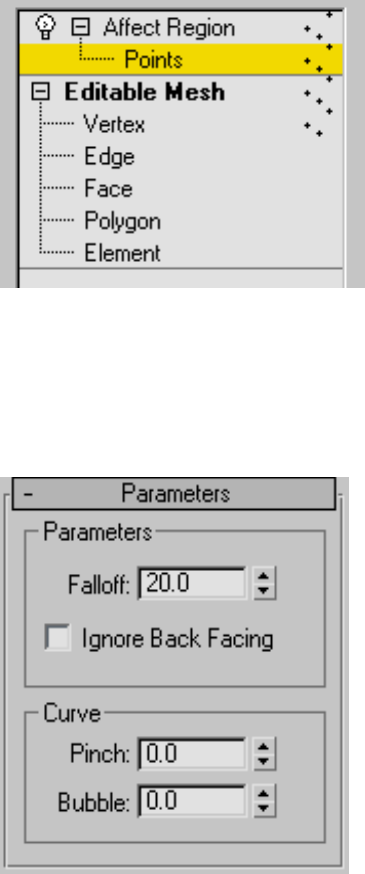
Modifier Stack
Point sub-object level At this sub-object level, the base and tip of the gizmo
arrow are points that can be selected. You can select, translate, and animate
these two points together or individually.
For more information on the stack display, see Modifier Stack on page 7427 .
Parameters rollout
Affect Region Modifier | 1135
Parameters group
Falloff Sets the radius of affected vertices, in units, from the base of the gizmo
arrow. (Spinner value range: float, 0.0 to 999,999.0)
Ignore Back Facing Affects only those vertices whose face normals are in the
same general direction as the gizmo arrow. When turned off, all vertices in
the Falloff group are affected.
Curve group
Pinch Affects the tangency of the curve where it meets the arrow tip. Positive
values produce a pointed tip while negative values produce a dimple. (Spinner
value range: float, -999,999.0 to 999,999.0)
Bubble Changes the curvature of the affected vertices. A value of 1.0 produces
a half-dome. As you reduce this value, the sides of the dome slope more steeply.
Negative values lower the base of the curve below the base of the arrow gizmo.
(Spinner value range: float, -999,999.0 to 999,999.0)
Attribute Holder Modifier
Create or select an object. > Modify panel > Modifier List > Object–Space
Modifiers > Attribute Holder
Create or select an object > Modifiers menu > Animation > Attribute Holder
The Attribute Holder modifier is an empty modifier that provides a readily
accessible user interface on the Modify panel to which you can add custom
attributes on page 267 . It has no user interface of its own; the interface consists
solely of those attributes you assign to it. In essence, Attribute Holder is a
stripped-down version of Parameter Collector on page 285 that can collect
only custom attributes and appears on the Modify panel instead of a floating
dialog.
Procedures
Example: To collect different custom attributes in an Attribute Holder modifier:
Before undertaking this procedure, you should be familiar with basic usage of
the Parameter Wiring dialog on page 3249 .
1Add a small box to an empty scene. Make it about 20.0 units on a side.
2Apply a Taper modifier and an Attribute Holder modifier, in that order.
1136 | Chapter 9 Modifiers
In the modifier stack, the Attribute Holder modifier should be highlighted.
3From the Animation menu, choose Parameter Editor.
4In Parameter Editor, on the Attribute Rollout, make or ensure the
following settings:
■Add to Type=Selected Object's Current Modifier
■Parameter Type=Float
■UI Type=Slider
■Name=Box Height
5On the Float UI Options rollout, keep all the default settings.
6On the Attribute Rollout, click Add.
The Custom Attributes rollout appears on the Modify panel, containing
the new Box Height slider.
7Add another attribute:
■Add to Type=Selected Object's Current Modifier
■Parameter Type=Integer
■UI Type=Spinner
■Name=Box Height Segs
■Integer UI Options > Range=From 1 to 50.
8Add two more Float/Spinner attributes named Taper Amount and Taper
Curve.
The Attribute Holder modifier now has four custom attributes, but they
don't do anything because they're not connected. You'll use Parameter
Wiring to hook them up.
9Close the Parameter Editor dialog.
10 In the active viewport, right-click the box and choose Wire Parameters.
From the pop-up menu that appears, choose Modified Object > Box
(Object) > Height.
A rubber-band dashed line appears connecting the mouse cursor to the
box.
Attribute Holder Modifier | 1137
11 You can't connect this “wire” directly to the custom attribute, so just
left-click in an empty part of the viewport to open the Parameter Wiring
dialog.
The hierarchy list on the left side, Box01, is expanded to the box's Height
parameter, which is highlighted.
12 On the right side, expand this path: Object > Box01 > Modified Object
> Attribute Holder > Custom Attributes, and then click Box Height to
highlight it.
13 Click the Two-way Connection button (double-headed arrow), and then
click Connect.
14 Similarly, connect Height Segments on the left side to Box Height
Segments on the right.
15 Close the Parameter Wiring dialog.
16 Right-click the box again, choose Parameter Wiring, choose Modified
Object > Taper > Amount, and then left-click to open the Parameter
Wiring dialog.
The Amount parameter is highlighted on the left side of the dialog.
17 On the right side, click the Attribute Holder's Taper Amount parameter,
and then connect them.
18 Connect Curvature on the left side to Taper Curve on the right side, and
then close the dialog.
All the parameters are now hooked up.
19 Experiment with changing the values on the Custom Attributes rollout.
The Attribute Holder modifier lets you change the box's creation
parameters as well as the Taper modifier's settings without switching back
and forth in the modifier stack. In this way you can access, in one
convenient location, as many different parameters from different levels
in an object's modifier stack, or even from different objects, as you like.
You might notice that you can't set the taper to curve inward. You can
resolve this by reopening Parameter Editor, clicking Edit/Delete, and then
modifying the Taper Curve attribute to allow negative values. The change
takes effect immediately, with no rewiring required.
1138 | Chapter 9 Modifiers
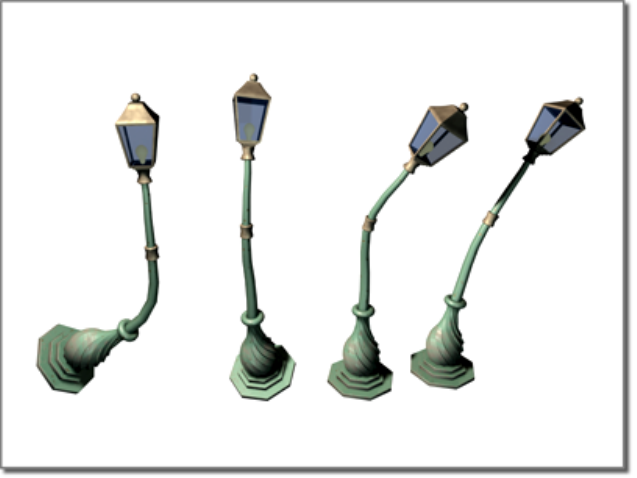
Bend Modifier
Modify panel > Make a selection. > Modifier List > Object-Space Modifiers >
Bend
Make a selection. > Modifiers menu > Parametric Deformers > Bend
The Bend modifier lets you bend the current selection up to 360 degrees about
a single axis, producing a uniform bend in an object's geometry. You can
control the angle and direction of the bend on any of three axes. You can also
limit the bend to a section of the geometry.
Bend applied to a streetlight model
Procedures
To bend an object:
1Select an object and apply the Bend modifier.
2On the Parameters rollout, set the axis of the bend to X, Y, or Z. This is
the axis of the Bend gizmo, not the axis of the selected object.
Bend Modifier | 1139
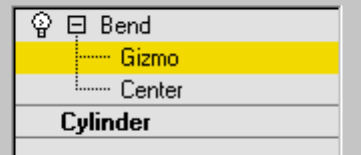
You can switch between axes at any time, but the modifier carries only
one axis setting.
3Set the angle of the bend along the chosen axis.
The object bends to this angle.
4Set the direction of the bend.
The object swivels around the axis.
You can reverse angle and direction by changing a positive value to a negative
value.
To limit the bend:
1Turn on Limit Effect in the Limits group.
2Set values for the upper and lower limits. These are distances in current
units above and below the modifier's center, which is at zero on the
gizmo's Z axis by default. You can make the upper limit zero or positive,
and the lower limit zero or negative. If the limits are equal, the result is
the same as turning off Limit Effect.
The bend is applied between these limits. The surrounding geometry,
while unaffected by the bend itself, rotates to keep the object intact. This
is analogous to bending a pipe, where the unbent sections rotate but
remain straight.
3At the sub-object level, you can select and move the modifier's center.
The Limit settings remain on either side of the center as you move it. This lets
you relocate the bend area to another part of the object.
Interface
Modifier Stack
1140 | Chapter 9 Modifiers
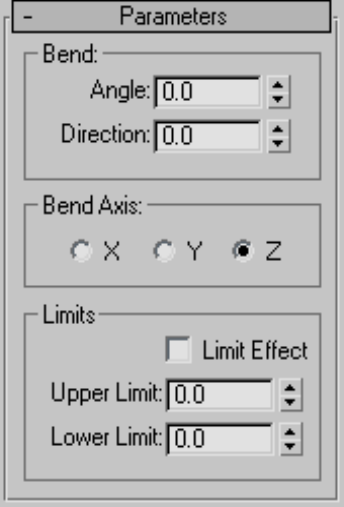
Gizmo sub-object You can transform and animate the gizmo like any other
object at this sub-object level, altering the effect of the Bend modifier.
Translating the gizmo translates its center an equal distance. Rotating and
scaling the gizmo takes place with respect to its center.
Center sub-object You can translate and animate the center at this sub-object
level, altering the Bend gizmo's shape, and thus the shape of the bent object.
For more information on the stack display, see Modifier Stack on page 7427 .
Parameters rollout
Bend group
Angle Sets the angle to bend from the vertical plane. Range=-999,999.0 to
999,999.0.
Direction Sets the direction of the bend relative to the horizontal plane.
Range=-999,999.0 to 999,999.0.
Bend Modifier | 1141
Bend Axis group
X/Y/Z Specifies the axis to be bent. Note that this axis is local to the Bend
gizmo and not related to the selected entity. Default=Z.
Limits group
Limit Effect Applies limit constraints to the bend effect. Default=off.
Upper Limit Sets the upper boundary in world units from the bend center
point beyond which the bend no longer affects geometry. Default=0. Range=0
to 999,999.0.
Lower Limit Sets the lower boundary in world units from the bend center
point beyond which the bend no longer affects geometry. Default=0.
Range=-999,999.0 to 0.
Bevel Modifier
Select a shape. > Modify panel > Modifier List > Bevel
The Bevel modifier extrudes shapes into 3D objects and applies a flat or round
bevel to the edges. A common use for this modifier is to create 3D text and
logos, but you can apply it to any shape.
Bevel takes a shape as the base of a 3D object. You then extrude the shape up
to four levels and assign an outline amount for each level.
1142 | Chapter 9 Modifiers
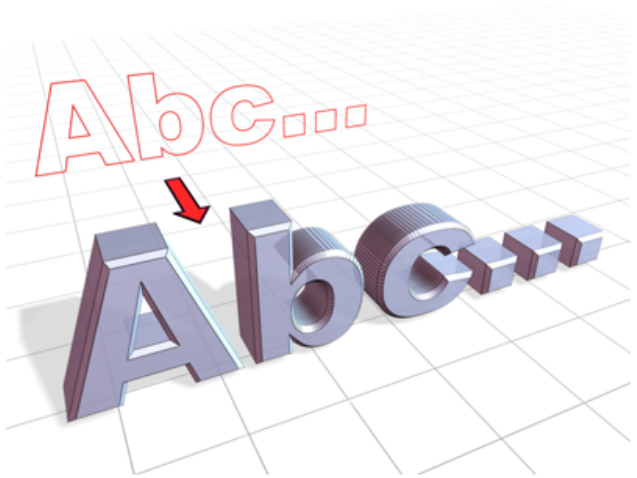
Beveled text
Procedures
Example: To create beveled text:
This example produces typical 3D beveled text, with equal bevels in front and
back.
1Create text on page 569 using default settings.
Font=Arial, Size=100.0.
2Apply the Bevel modifier.
3Type -1.0 in the Start Outline field.
4For Level 1, do the following:
■Type 5.0 for Height.
■Type 2.0 for Outline.
5Turn on Level 2, and do the following:
■Type 5.0 for Height.
Bevel Modifier | 1143
■Type 0.0 for Outline.
6Turn on Level 3 and do the following:
■Type 5.0 for Height.
■Type -2.0 for Outline.
7If needed, turn on Keep Lines From Crossing.
1144 | Chapter 9 Modifiers

Interface
Parameters rollout
Bevel Modifier | 1145

Capping group
You can determine whether or not the beveled object is capped at either end
with the check boxes in the Capping group.
Start Caps the end with the lowest local Z value (bottom) of the object.
When turned off, the bottom is open.
End Caps the end with the highest local Z value (top) of the object. When
turned off, the end is left open.
Cap Type group
Two radio buttons set the type of cap used.
Morph Creates cap faces suitable for morphing.
Grid Creates cap faces in a grid pattern. This cap type deforms and renders
better than morph capping.
Surface group
Controls the side curvature, smoothing, and mapping of the surface.
The first two radio buttons set the interpolation method used between levels;
a numeric field sets the number of segments to interpolate.
Linear Sides When active, segment interpolation between levels follows a
straight line.
Curved Sides When active, segment interpolation between levels follows a
Bezier curve. For visible curvature, use multiple segments with Curved Sides.
Segments Sets the number of intermediate segments between each level.
Four-level bevels with 1 and 2 segments
1146 | Chapter 9 Modifiers
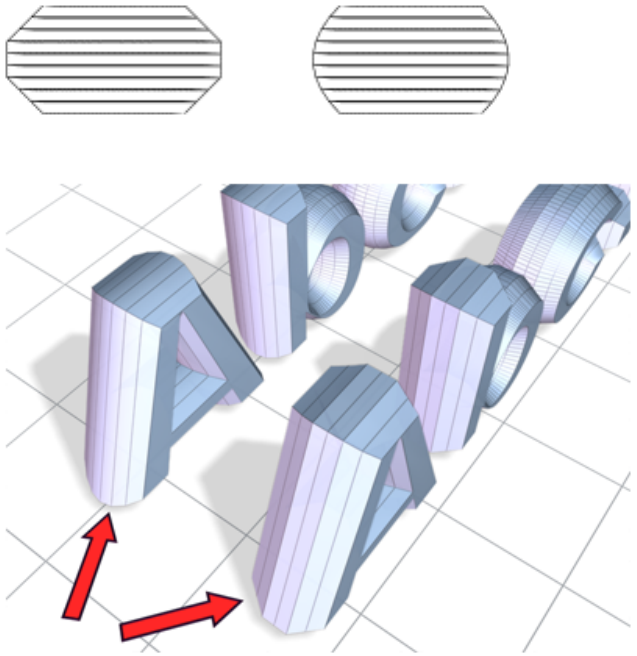
Bevels with linear and curved sides
Rounding and smoothing the bevel object sides
Smooth Across Levels Controls whether smoothing groups are applied to
the sides of a beveled object. Caps always use a different smoothing group
than the sides.
■When turned on, smoothing groups are applied to the sides. The sides
appear rounded.
■When turned off, smoothing groups are not applied. The sides appear as
flat bevels.
Generate Mapping Coordinates When turned on, mapping coordinates are
applied to the beveled object.
Bevel Modifier | 1147
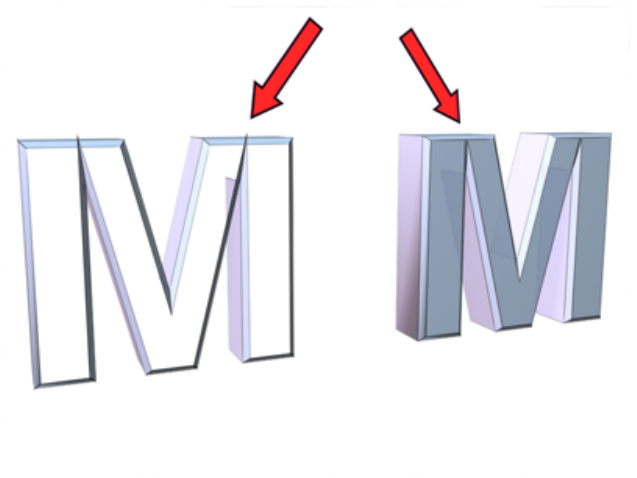
Real-World Map Size Controls the scaling method used for texture mapped
materials that are applied to the object. The scaling values are controlled by
the Use Real-World Scale settings found in the applied material's Coordinates
rollout on page 5620 . Default=on.
Intersections group
Prevents sharp corners from overlapping neighboring edges.
Bevel works best with rounded shapes or shapes with corners greater than 90
degrees. Acute angles (less than 90 degrees) produce extreme bevels and often
overlap nearby edges.
Keep Lines From Crossing Prevents outlines from crossing over themselves.
This is accomplished by inserting extra vertices in the outline and replacing
sharp corners with a flat line segment.
Using Keep Lines From Crossing:
Left: Off
Right: On
Separation Sets the distance to be maintained between edges. The minimum
value is 0.01.
1148 | Chapter 9 Modifiers
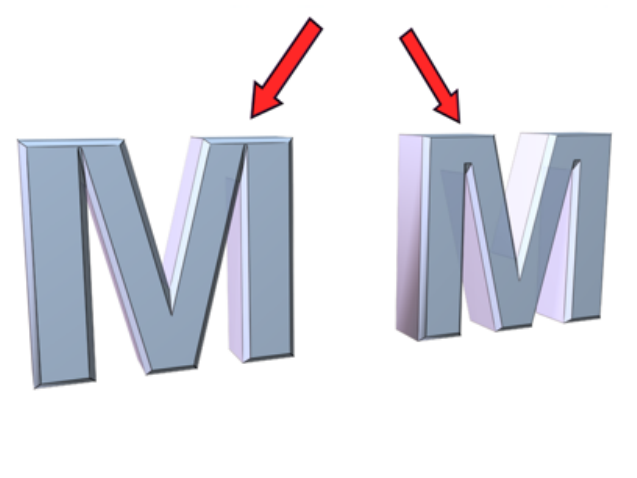
Changing the Separation value
Bevel Values rollout
Contains the parameters that set the height and bevel amount of up to four
levels.
A beveled object requires a minimum of two levels: a start and an end. You
add more levels to vary the amount and direction of bevel from start to end.
You can think of bevel levels as layers on a cake. The Start Outline is the
bottom of the cake and the Level 1 parameters define the height and size of
the first layer.
Turning on Level 2 or Level 3 adds another layer to the beveled object with
the height and outline specifying the amount of change from the previous
level.
The last level on is always the top of the object.
You must always set the Level 1 parameters.
Bevel Modifier | 1149
Start Outline Sets the distance the outline is offset from the original shape.
A non-zero setting changes the original shape's size.
■Positive values make the outline larger.
■Negative values make the outline smaller.
Level 1 Includes two parameters that indicate the change from the Start
level.
Height Sets the distance of Level 1 above the Start level.
Outline Sets the distance to offset the Level 1 outline from the Start Outline.
Levels 2 and Level 3 are optional and allow you to change the bevel amount
and direction.
Level 2 Adds a level after Level 1.
Height Sets the distance above Level 1.
Outline Sets the offset distance of the Level 2 outline from Level 1.
Level 3 Adds a level after the previous level. If Level 2 is not on, Level 3 is
added after Level 1.
Height Sets the distance above the previous level.
Outline Sets the offset distance of Level 3 from the previous level.
Traditional beveled text uses all levels with these typical conditions:
■Start Outline can be any value, usually 0.0.
■Level 1 Outline is a positive value.
■Level 2 Outline is 0.0. No change from Level 1.
■Level 3 Outline is the negative of Level 1. Returns Level 3 to the same size
as the Start Outline.
Bevel Profile Modifier
Select a shape. > Modify panel > Modifier List > Bevel Profile
The Bevel Profile modifier extrudes a shape using another shape path as the
"beveling profile." It's a variation on the Bevel modifier on page 1142 .
1150 | Chapter 9 Modifiers
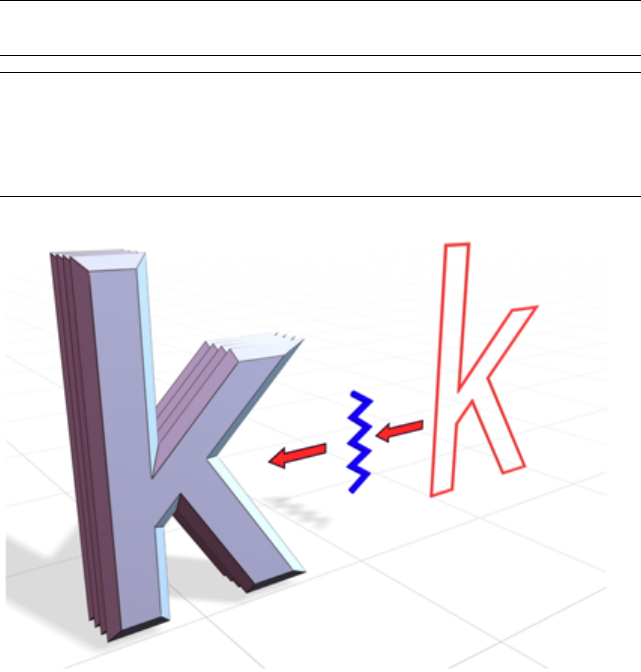
IMPORTANT Bevel Profile fails if you delete the original beveling profile. Unlike
a loft object, which incorporates the shape, Bevel Profile is simply a modifier.
NOTE Although this modifier might seem similar to a loft object with varying
scale settings, it's actually different because it uses different outline values as
distances between line segments rather than as scale values. This more complex
method of resizing a shape results in some levels having either more or less vertices
than others, and generally works better with text, for example.
Bevel Profile creates an object using an open spline.
Bevel Profile Modifier | 1151
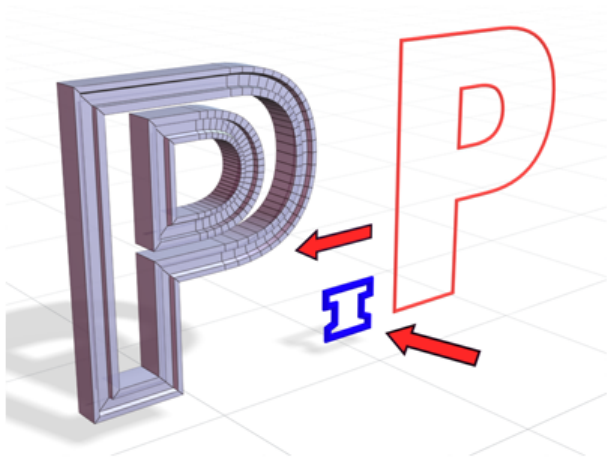
Bevel Profile creates an object using a closed spline, yielding a different result.
Procedures
To use the Bevel Profile modifier:
1Create the shape you want to bevel (preferably in the Top viewport).
2In the Front (XZ) viewport, create a shape to use as the beveling profile.
3Select the first shape and apply the Bevel Profile modifier.
4Click the Pick Profile button in the Bevel Profile modifier, and then click
the profile shape.
1152 | Chapter 9 Modifiers
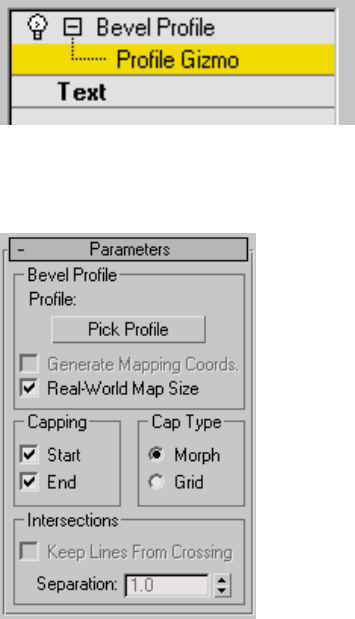
Interface
Modifier Stack
For more information on the stack display, see Modifier Stack on page 7427 .
Parameters rollout
Bevel Profile group
Pick Profile Selects a shape or NURBS curve to be used for the profile path.
Generate Mapping Coords Assigns UV coordinates.
Real-World Map Size Controls the scaling method used for texture mapped
materials that are applied to the object. The scaling values are controlled by
the Use Real-World Scale settings found in the applied material's Coordinates
rollout on page 5620 . Default=on.
Bevel Profile Modifier | 1153
Capping group
Start Caps the bottom of the extruded shape.
End Caps the top of the extruded shape.
Cap Type group
Morph Selects a deterministic method of capping that provides the same
number of vertices for morphing between objects.
Grid Creates gridded caps that are better for cap deformations.
Intersections group
Keep Lines From Crossing Prevents beveled surfaces from self intersecting.
This requires more processor calculation and can be time-consuming in
complex geometry.
Separation Sets the distance that sides should be kept apart to prevent
intersections.
Camera Map Modifier (Object Space)
Select one object. > Modify panel > Modifier List > Object-Space Modifiers >
Camera Map
Select one object. > Modifiers menu > UV Coordinates > Camera Map
The Camera Map modifier (object-space version) assigns planar mapping
coordinates based on the current frame and the camera specified in the Camera
Map modifier. This differs from the Camera Map (WSM) modifier on page
1043 that updates the object's mapping coordinates on every frame.
1154 | Chapter 9 Modifiers
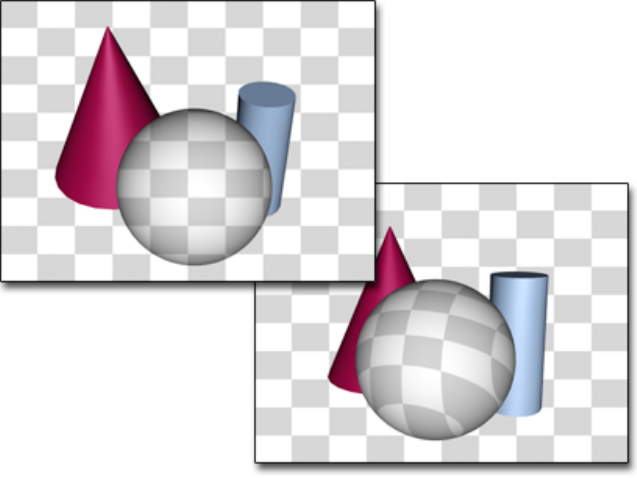
Left: The texture of an object with a camera map modifier matches the background
when seen by the camera the modifier uses.
Right: When seen by a camera not used by camera map, the object’s texture is based
on object geometry.
Blending an Object into the Background
In the Procedures section (below), you'll be blending an object into the
background using the Camera Map modifier. If the background uses the same
image as the object's texture map, then the object blends with the background
at the frame where the modifier is applied and a camera is specified. The object
becomes visible if either the camera or object moves. In order to make the
illusion work, you must assign the same map to the background that you
assign to the object.
Mapping Coordinates
Because the accuracy of mapped objects depends partly on the complexity of
the mesh, the "blend to background" effect works best when applied to an
object with a relatively high density of triangular faces. The necessary density
also depends on the distance of the object from the camera.
Camera Map Modifier (Object Space) | 1155

A simple box might look fine when it occupies only a small portion of the
background, but up close the mapping will look distorted without adequate
tessellation. Some experimentation is required to get an ideal mapping and
still minimize the complexity of the geometry. (In general, for a box object
that's filling a quarter of the screen, a tessellation of 4x4x4 works well.)
NOTE When using the Camera Map modifier, apply the modifier to a single object
at a time. If it's applied to a selection set, only the first item in the selection will
be mapped properly.
Use Camera Map (WSM) on page 1043 if you want to move the camera and
maintain the match to the background.
Using the Plate Match/MAX R2.5 Rendering Filter
Prior to 3ds Max 3, the antialiasing affected only geometric edges, with the
filtering of bitmaps being controlled in the Bitmap Map parameters (pyramidal,
summed area, or no filtering). Antialiasing filters affect every aspect of the
object, filtering textures along with geometric edges. While antialiasing
provides superior results, it produces inconsistencies when rendering objects
that are supposed to match the environment background. This is because the
antialiasing filters do not affect the background by default. You can turn on
background antialiasing in Customize > Preferences > Rendering > Background
Antialiasing > Filter Background. To correctly match an object’s map to an
unfiltered background image, you need to use the Plate Match/MAX R2.5 filter
so the texture is not affected by the antialiasing.
There are three ways you can render objects in 3ds Max to blend seamlessly
into a background environment:
■By assigning a Matte/Shadow Material
■By assigning a 100% self-illuminated diffuse texture to an object using
Camera Mapping
■By assigning a 100% self-illuminated diffuse texture using
Environment/Screen projection
The Plate Match/MAX R2.5 antialiasing should be used whenever trying to
match foreground objects with an unfiltered background or when trying to
match the antialiasing qualities of the 3ds Max 2.5 renderer.
1156 | Chapter 9 Modifiers

Procedures
The following steps show how to apply the Camera Map modifier, and how
to set up your scene.
To apply the Camera Map modifier:
1Create a scene with a camera and one or more objects. Make sure the
object you want to map is visible in the Camera viewport.
2Select the object, and apply the Camera Map modifier.
Be sure to use the Object-Space version of the Camera Map modifier.
3If you have animation in the scene, move to the frame where you want
the object map to match the background. For example, if the camera is
animated, the mapping will match only at this frame.
4On the Camera Mapping rollout, click Pick Camera, and then select the
camera used for the rendered view.
To assign a background image to the Camera viewport:
NOTE This procedure is not necessary for successful rendering, but if you want
to see the effect in a viewport, follow these steps.
1Activate the Camera viewport and turn off the grid.
2Choose Views menu > Viewport Background.
3On the Viewport Background dialog that displays, click the Files button,
and choose the same bitmap that you plan to apply as a background for
the rendered scene, and as a diffuse map on the object.
4In the Aspect Ratio group, choose Match Rendering Output.
5Turn on Display Background, and click OK.
The dialog is dismissed and the map is displayed in the viewport.
To assign a mapped material to the object:
1In the Material Editor, create a standard material to whose Diffuse
component you've assigned the same bitmap as you assigned to the
background.
2At the Diffuse Map level of the material, turn on the Show Map In
Viewport button.
Camera Map Modifier (Object Space) | 1157
3Select the object, and click Assign Material To Selection.
The map on the object in the viewport matches the viewport background,
but the shading makes the object visible. To make the object truly
invisible, go to the next step.
4At the top level of the object's material, set Specular Level and Glossiness
to 0. Turn off Self Illumination Color, and set Self Illumination to 100.
The object is now camouflaged against the background.
To assign the background to the rendered background:
1Choose Rendering menu > Environment.
2In the Environment dialog that displays, click the button below
"Environment Map" to open the Material/Map Browser.
3Under the Browse From group box, choose Material Editor.
4Turn off Root Only, find the map in the list window, highlight it, and
choose OK.
5Choose Copy in the dialog, and click OK.
6In the Exposure Control rollout on the Environment dialog, make sure
the exposure is set to <no exposure control> or the turn off the Active
switch.
If this is not done, you will be able to see the object in the rendering.
7Render the Camera viewport.
The mapped object is camouflaged against the background in the rendered
scene.
1158 | Chapter 9 Modifiers
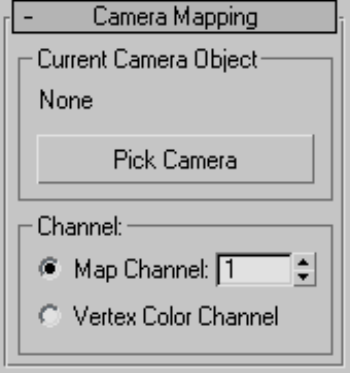
Interface
Pick Camera To apply the UVW coordinates, click this button, and then
select the camera through which you're going to view the scene.
Map Channel Turn on and choose a map channel to use. Map channels are
specified in the Material Editor.
Vertex Color Channel Uses the Vertex Color channel.
Cap Holes Modifier
Select a mesh object. > Modify panel > Modifier List > Cap Holes
Select a mesh object. > Modifiers menu > Mesh Editing > Cap Holes
Cap Holes Modifier | 1159
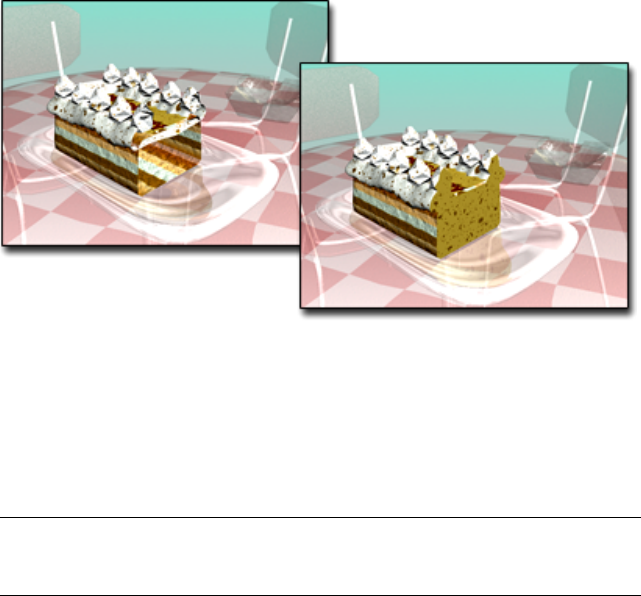
Cap Holes used to make the cake appear solid
The Cap Holes modifier builds faces in the holes in a mesh object. A hole is
defined as a loop of edges, each of which has only one face. For example, one
or more missing faces from a sphere would produce one or more holes. The
modifier works best on reconstructing planar holes, but can do a reasonable
job on non-planar holes as well.
NOTE This modifier can cap holes in a sub-object selection passed up the stack.
It caps any part of the hole that's adjacent to, or within the selected geometry,
whether vertex, edge, or face.
Tips
■If the Cap Holes modifier doesn't appear to work, remove it, apply a Mesh
Select modifier on page 1455 to select the faces surrounding the hole, then
apply Cap Holes to the sub-object selection.
■The Cap Holes modifier creates faces with invisible edges unless you turn
on All New Edges Visible before you apply it.
Procedures
Example: To cap a hole in a sphere:
1Create a sphere.
2Apply an Edit Mesh modifier to the sphere.
1160 | Chapter 9 Modifiers
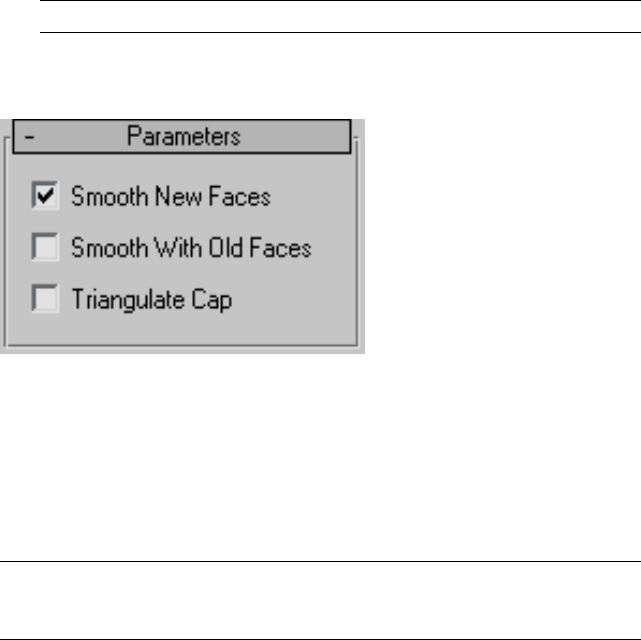
3In the stack display, choose the Face selection level.
4Select and delete a contiguous group of faces.
5Turn off the Face selection level.
6Apply a Cap Holes modifier.
The hole you created should be filled.
TIP Turning on Smooth With Old Faces makes the cap less visible.
Interface
Smooth New Faces Assigns the same smoothing group number to all new
faces. If possible, this will be a smoothing group number not used elsewhere
in the object.
Smooth With Old Faces Smoothes new triangular faces using the smoothing
groups from bordering old faces. This smoothes only one level in from the
perimeter of the border of the hole, so you might need to use both this and
the Smooth New Faces option to properly smooth a large hole.
NOTE When Smooth With Old Faces is turned on, the faces in the capped holes
inherit a material face ID from one of the surrounding faces. When this item is
turned off, the faces in the capped holes are assigned a new ID.
Triangulate Cap Makes all of the edges visible in the new faces.
Cap Holes Modifier | 1161
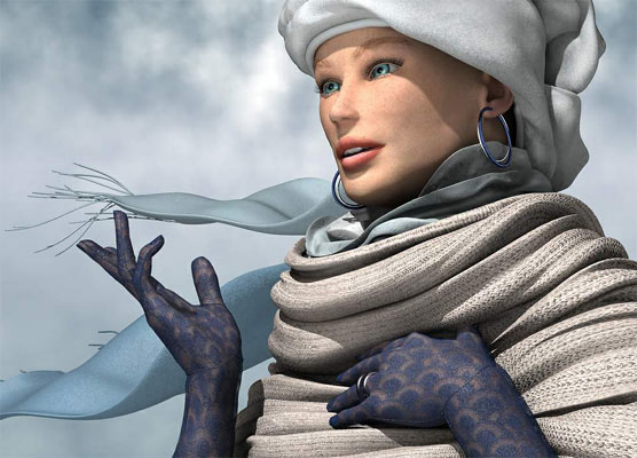
Cloth and Garment Maker Modifiers
Laura by Georges Walser
Cloth provides you with advanced tools for creating realistic fabrics and
tailor-made clothing for characters and creatures. The Cloth system comprises
two modifiers:
■The Cloth modifier on page 1178 is responsible for simulating the motion
of cloth as it interacts with the environment, which may include collision
objects (a character or a table, for example) and external forces, such as
gravity and wind.
■The Garment Maker modifier on page 1228 is a specialized tool for creating
3D garments from 2D splines, similarly to the way real clothes are made,
by stitching together flat pieces of cloth.
You can model clothing in two ways: by creating the cloth objects with
standard 3ds Max modeling methods and applying the Cloth modifier to
them, or by designing virtual clothing patterns with splines and stitching
together these various virtual panels to form a full garment using the Garment
Maker modifier. With Garment Maker, you can even import spline patterns
from external applications and use these as your pattern panels.
1162 | Chapter 9 Modifiers
See also:
■Cloth Overview on page 1163
Cloth Overview
Cloth is an advanced cloth-simulation engine that lets you create realistic
garments for your characters and other creations. Cloth is designed to work
in concert with the modeling tools in 3ds Max and can turn just about any
3D object into clothing; it also allows you to build garments from scratch.
Before you begin working with Cloth, we recommend that you read this
overview. It provides background information on cloth-simulation technology,
so you can begin to grasp exactly the way Cloth works. It will give you a better
overall understanding of how to set up Cloth scenes, the way the cloth behaves,
and the array of advanced controls you will have at your disposal.
As an artist and creator, you can use this knowledge to tailor (no pun intended)
how Cloth will affect and interact with your scenes, and how you can best
take advantage of this software.
Cloth-Simulation Technology
Cloth simulation is the process of replicating the movement and deformation
of a piece of fabric or clothing to mimic how cloth would react in the real
world. To make cloth simulation work, first you need a cloth object, such as
a tablecloth or a pair of pants. Next, you need something for the fabric to
interact with. This can be a collision object such as a table top or character’s
leg, or a force such as wind or gravity.
Limitations
While Cloth is designed to help you create clothing for your models, you
should be aware that, by its very nature, cloth simulation is only an
approximation of how real fabric would react under certain circumstances;
this system does have some limitations.
One of the most important aspects of working with Cloth is the amount of
time it can take to create a simulation. If you're looking to create a fully
physically correct simulation, you might run into problems. Even with a fast
computer, cloth dynamics at that level of accuracy (and geometric detail)
could take virtually forever. So you must learn to scale your simulations back
Cloth and Garment Maker Modifiers | 1163
to a reasonable level. This doesn't mean you can't get believable clothing; it
simply means that there are tradeoffs you should be willing to make.
Tradeoffs
In order to create a believable simulation, you need to balance time against
quality and accuracy. The more time you have, the more accuracy and quality
your simulation can have. There's no reason to make a model with 10,000
polygons if you can define the form equally well with 3,000. The same rule
applies to cloth simulations.
Internal and External Forces
When simulating cloth, different forces come into play. Some internal forces
like bend, stretch, and shear allow the fabric to deform in a realistic manner.
External forces such as gravity, wind, and collisions make the cloth interact
with its environment. To obtain a good-looking simulation, most or all of
these things need to come into play. Without these forces, a piece of cloth
will remain a flat, lifeless plane.
Collision Detection
When putting a shirt or pair of pants on a character, you don't want any part
of the body to protrude through the fabric. The desired result is to have the
garment deform around the mesh (rather than through it) so there are no
intersections. This is done with collision detection; with Cloth, you tell the
simulation system which objects will act as cloth, and which ones will act as
collision objects.
Basically, virtual feelers are sent out from the vertices of the cloth objects to
see if there are any other objects that they might collide with. When one of
the feelers hits something, the simulation knows that it must deform the
fabric. It is important to remember that a cloth mesh with more vertices has
more feelers and can do a better job of collision detection. This is critical,
because if you are working with a high-poly character (collision object), you
will need to increase the density of your cloth, or the high-poly mesh will
protrude through the lower-poly cloth object. The reason is that there aren't
enough feelers to detect all of the detail in the collision object.
The alternative to this is to add one or more low-polygon proxy meshes for
the character so there doesn't need to be such high density cloth objects that
will slow down simulation. We'll cover the mesh density a bit more in the
next section.
1164 | Chapter 9 Modifiers
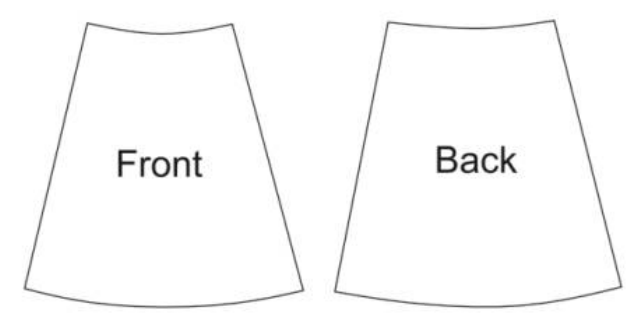
Lastly, if you are simulating with fast-moving cloth objects, you might need
to increase the Density value to give you the benefit of more feelers. You also
might adjust the Step size to check more often for collision objects in the way.
Clothing and Pattern Design Overview
Traditionally, sewing patterns are cut from flat pieces of cloth and stitched
together. The place where one piece of cloth is sewn to another is called a
seam. Patterns are generally symmetrical, where the left side of the garment
matches the right.
Skirt
The simplest is a skirt pattern with two pieces, with a similar shape for the
front and back. The back shape is a little larger than the front to account for
the hips and buttocks.
The shapes are sewn together at the sides to form a simple skirt.
Cloth and Garment Maker Modifiers | 1165
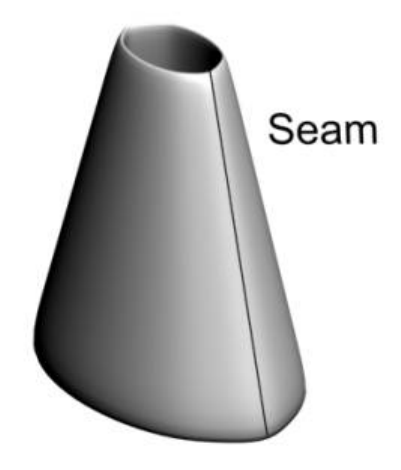
The bottom edge of a garment is called a hem. In the skirt pattern, the waistline
and hem are slightly curved. When a person puts on the skirt, the curve sits
flat on the waist, while the skirt falls in folds to the hem. Because both the
waistline and hem are curved, the skirt falls to the same length all the way
around.
Shirt
A shirt pattern is slightly more complicated. A simple T-shirt pattern is made
of two pieces, one for the front and another for the back. The collar on the
back piece is higher than the collar on the front. You sew seams up the sides
and at the shoulders, leaving the arm hole open.
1166 | Chapter 9 Modifiers
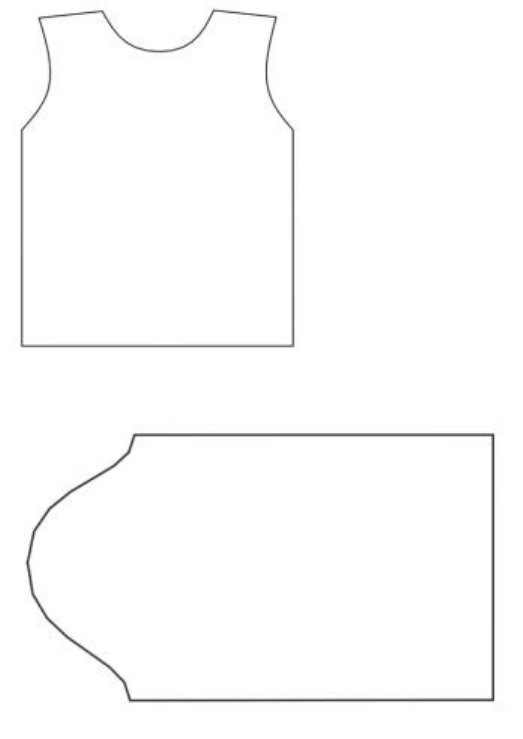
You can also add sleeves to the shirt. A sleeve pattern is bell-shaped.
It might not be immediately obvious how this pattern turns into a sleeve. The
large hump of the bell fits over the shoulder, to give room for it to move.
Cloth and Garment Maker Modifiers | 1167
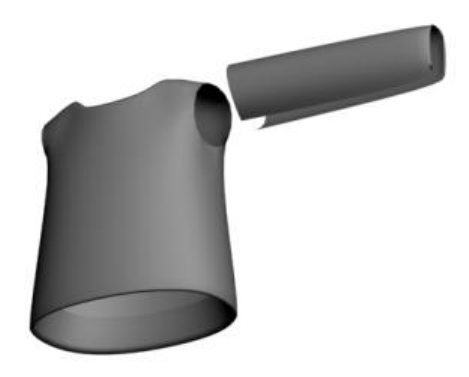
Pants
A pants pattern has a curved shape at the top to accommodate the hips. The
longer straight edge is the outside seam, while the shorter edge is the inseam.
The curve near the top fits around the belly or buttocks, and under the crotch
area.
1168 | Chapter 9 Modifiers
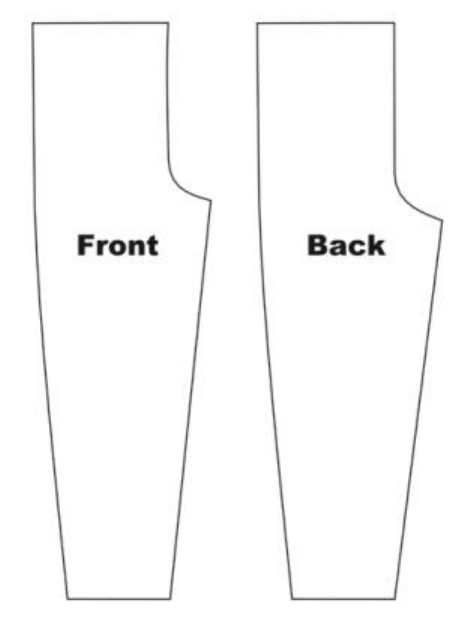
Each piece is cut twice. The two front pieces are sewn together along the
crotch, and the two back pieces are sewn together in the same way. Then the
front is attached to the back at the outside seams and inseams.
Cloth and Garment Maker Modifiers | 1169
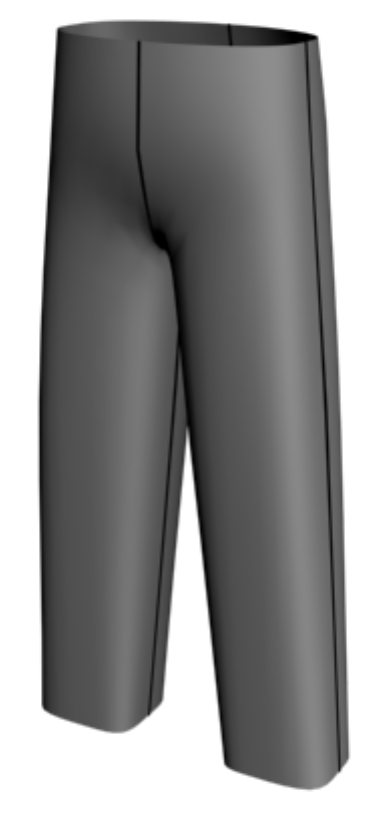
Darts
Darts are diamond-shaped holes inside a panel or V-shaped cutouts at an edge
of a garment panel (see figure below), which when closed up cause the garment
to assume a curved shape.
1170 | Chapter 9 Modifiers
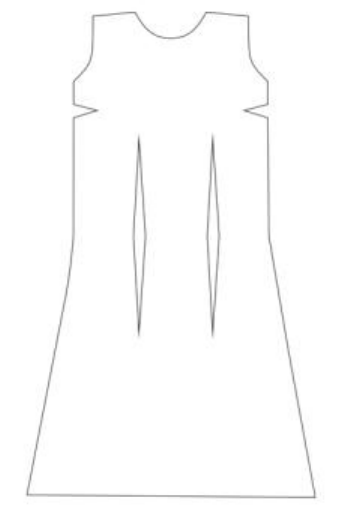
Cloth and Garment Maker Modifiers | 1171
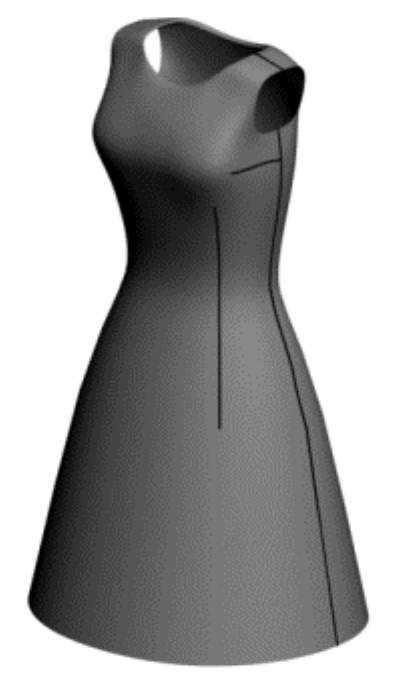
Darts used to be a common part of women's everyday clothing, especially in
blouses and dresses. However, darts are not needed with loose garments or
stretchy clothing. Today, they are used mostly in formal wear and tailored
garments.
Clothing Design and Techniques
One way to create clothing is to lay out a pattern and put it together with
Garment Maker. Garment Maker is a modifier that is used to make seams, lay
out cloth panels and define fabric densities. You can use Garment Maker to
create seams for the pattern either in a traditional, flat layout or in a visual,
easy-to-use 3D layout.
1172 | Chapter 9 Modifiers
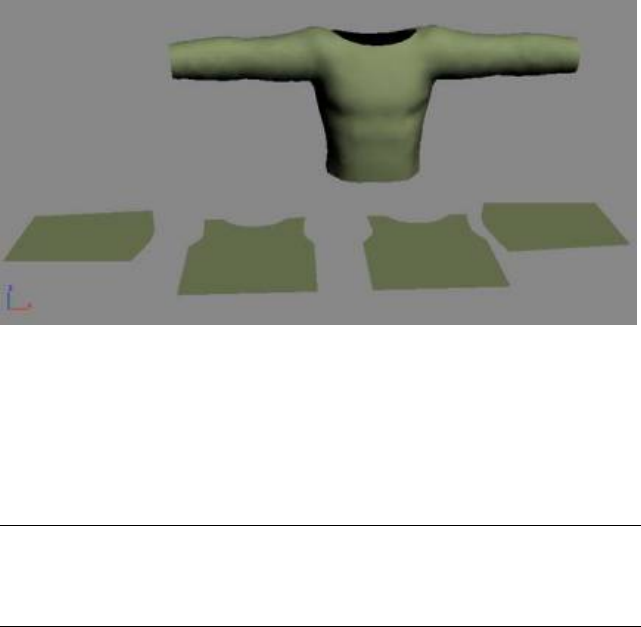
In the real world, clothes are made by cutting out shapes from pieces of cloth
and sewing them together along seams with thread. Garment Maker emulates
this approach. First you must create a pattern that will define the shapes of
the panels. Clothing patterns typically use shapes that we don't encounter in
everyday life. Those of us who aren't an experienced clothing designers might
have a hard time creating these shapes from scratch. It's often best to start out
with a pattern made by somebody else. Cloth includes a variety of patterns
for shirts, pants, jackets and so forth. You can also buy software that will
generate these patterns in DXF format.
One program that does this is PatternMaker, available from
http://www.patternmaker.com. When you want to move beyond editing the
patterns included with Cloth, it's often helpful to use such applications to
help create patterns and familiarize yourself with the process .
Shirt pattern and shirt sewn together with Garment Maker
Modeling Clothing
Garment Maker is a useful tool for putting together patterns and adjusting
seams, but you can also achieve good results by modeling with the standard
3ds Max tools and using Cloth on top of these meshes. You can create clothing
with polygons, patches, or NURBS.
IMPORTANT Keep in mind that modeled clothing must not have any overlapping
vertices or interpenetrating faces. This type of geometry can cause the simulation
to fail. Using Garment Maker; you will not run into this problem. If you are careful
in creating your mesh, then this is an easy rule to follow.
Pros and Cons
Cloth and Garment Maker Modifiers | 1173
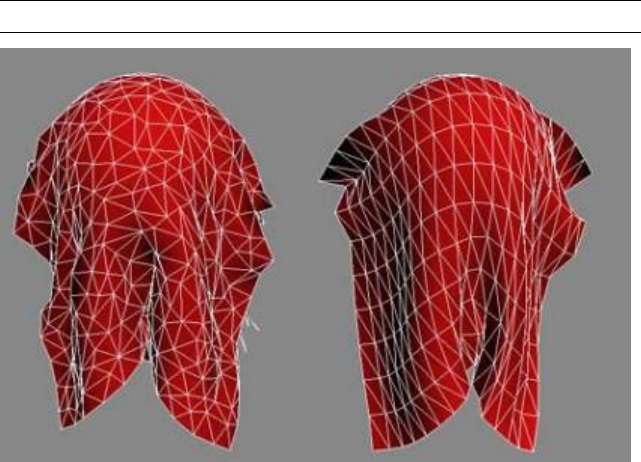
When designing clothing, Garment Maker is usually the best way to go. It lets
you define seams, seam strength, pleats, and other clothing parameters that
cannot be defined with clothing modeled via other methods. Either methods
lets you define separate portions of your clothing with different fabrics, but
Garment Maker gives you greater control over this. The advantage to using
modeled clothing is that it can sometimes be a faster setup with familiar
methods and it’s a great way to repurpose older clothing models you have
made in the past. Using polygon-modeled clothing can result in overly regular
creases and folds. Garment Maker uses a Delaunay mesh, which tends to avoid
this problem. However, the irregular triangulation can result in rendering
artifacts for low-resolution clothes, so it is advisable to apply the HSDS modifier
after Cloth on garments created with Garment Maker and subdivide all the
triangles once.
NOTE MeshSmooth does not give good results with Garment Maker meshes.
Left: Garment Maker Delaunay mesh
Right: Modeled quad mesh
How Cloth Works
Cloth exists within 3ds Max as a pair of modifiers: Garment Maker and Cloth.
Between these two, you can turn just about any 3D object into a cloth object,
or you can create clothing in a more traditional method from 2D patterns,
and then sew the panels together. However, before getting into the specifics
1174 | Chapter 9 Modifiers
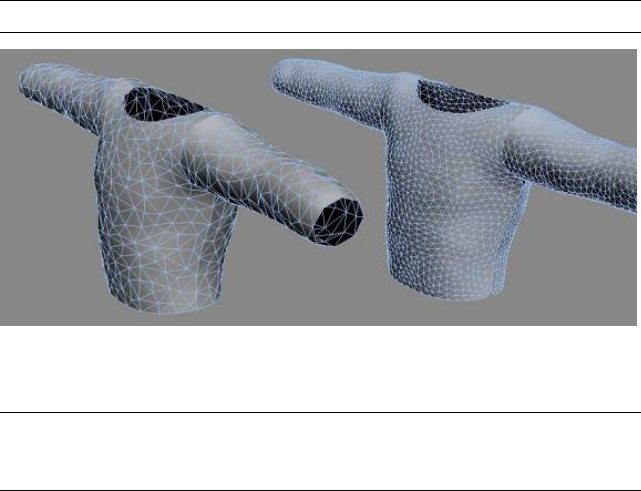
of the two modifiers, it's useful to discuss how to preplan for using Cloth. This
includes how geometry affects Cloth behavior as well as the density of the
meshes you use as fabric.
Effect of Geometry on Cloth
Ideally, the way you model your cloth should not affect how it behaves.
However, in practice, the nature of the cloth geometry impacts the simulation.
First of all, the density of the mesh defines how fine the folds are that can
develop. If you create a plane with only nine vertices, when you drape it over
a sphere, you are obviously not going to get much detailed folding.
In addition to this aspect, there is the nature of the edges in the mesh. Folding
can occur only at edges between triangles, so the regularity or irregularity of
the mesh also dictates the resulting deformation. For example, a plane all of
whose triangle hypotenuse edges are aligned will result in a cloth with folds
aligned along those edges. Garment Maker creates meshes with an irregular
layout (but with fairly equal-sized and close-to-equilateral triangles) that avoids
this folding bias. However, this can also result in rendering artifacts with
low-resolution cloths, so it is advisable to apply the HSDS modifier after Cloth
on garments created with Garment Maker and subdivide all the triangles once.
NOTE MeshSmooth does not give good results with Garment Maker meshes.
Left: A low-density shirt.
Right: The same shirt with HSDS applied, above Cloth in the modifier stack
NOTE There should never be any modifiers that can alter topology between
Garment Maker and Cloth. For example, you can use Unwrap UVW, but not
modifiers such as Edit Mesh, MeshSmooth, or HSDS.
Cloth and Garment Maker Modifiers | 1175
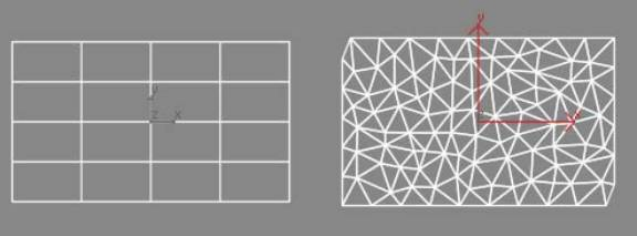
The type of geometry you work with can have a great impact on how the cloth
will react. You're probably accustomed to using triangular and quadrilateral
polygons for modeling. Garment Maker uses a Delaunay mesh subdivision
that promotes non-uniform deformation. When using quad polygons for cloth
simulation be careful of getting uniform or symmetrical results.
Left: A quad mesh
Right: A Delaunay mesh
Cloth Mesh Density
It is important to think about how dense your mesh has to be to achieve the
result you want. Making the mesh too dense will slow down the system, while
having your mesh at too low resolution might not give you the folds or detail
you want to see.
For example, if you applied a Bend modifier to a cylinder with only a few
height segments, the result would be angular and unsmooth. On the other
hand, if you created the cylinder with 1,000 height segments, you'd be wasting
resources. The same is true for Cloth. You must find a balance between level
of detail and performance that is appropriate for your scene.
1176 | Chapter 9 Modifiers
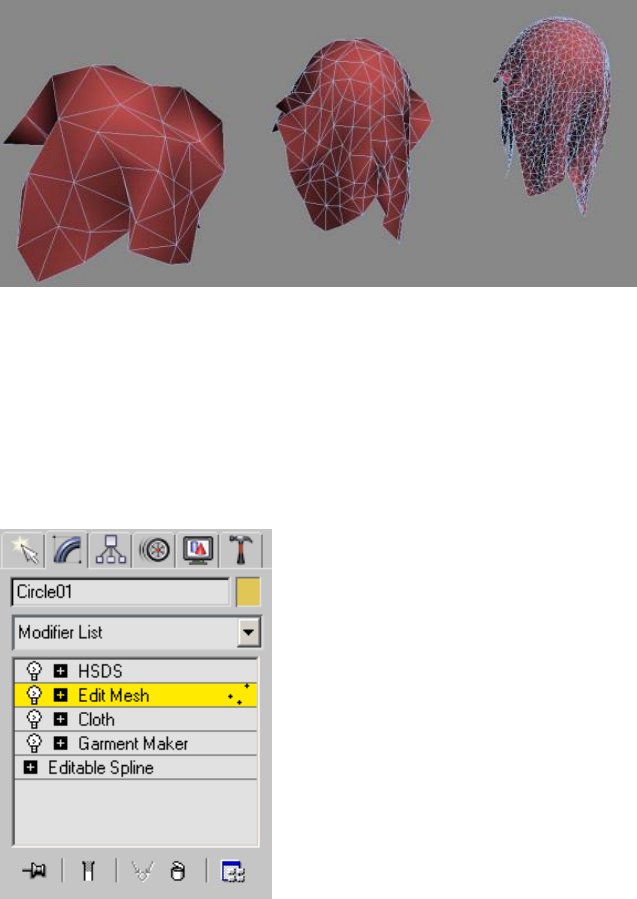
Low, medium, and high-density meshes and the way they deform
Notes on the HSDS Modifier
Using the HSDS modifier to add detail to your model can be an effective
solution that lets you simulate with a lower resolution mesh, and still get
high-quality results. However, if you choose to use the HSDS modifier on top
of your Cloth garments, you may want to apply an Edit Mesh modifier below
it to weld the vertices together along the seams. This prevents the mesh from
coming apart at the seams as it is subdivided.
Shown above is how the modifier stack should look when using HSDS. The
intermediate Edit Mesh modifier is used to weld the panel edge vertices
together. If you want to preserve the seam creases, you should apply further
Cloth and Garment Maker Modifiers | 1177
Mesh Select and Smooth modifiers to reselect the panels and apply different
smoothing groups across the garment.
Pattern-Making Software
Below is a list of traditional pattern-making software that you can use to create
patterns for import into 3ds Max and use with Cloth. After ensuring that your
Internet connection is active, click the software names to display the makers'
Web sites.
■http://www.fashioncad.net/index.htmlFashion CAD
■http://www.patternmaker.comPatternMaker
■http://www.wildginger.com/products/cameo.htmWild Ginger Software
■http://www.autometrix.comAutometrix
■AccuMark Pattern Design
■http://www.tukatech.comTUKATECH
See also:
■Cloth Modifier on page 1178
■Garment Maker Modifier on page 1228
Cloth Modifier
Select an object. > Modify panel > Modifier List > Object-Space Modifiers >
Cloth
The Cloth modifier is the heart of the Cloth system, and is applied to all
objects in your scene that need to be part of the Cloth simulation. This is
where you define cloth and collision objects, assign properties, and execute
the simulation. Other controls include creating constraints, interactively
dragging the cloth, and erasing parts of the simulation.
1178 | Chapter 9 Modifiers
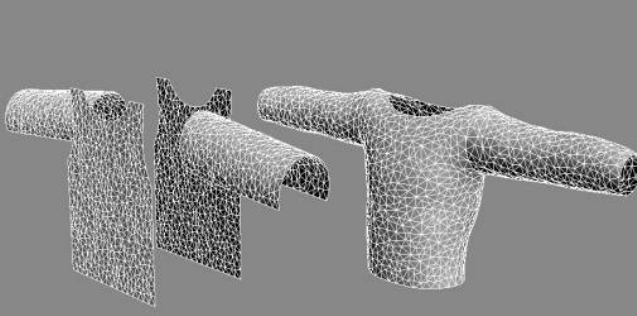
Left: Cloth modifier not yet applied
Right: Cloth modifier applied and simulated
See also:
■Object Properties Dialog (Cloth) on page 1219
■Cloth and Garment Maker Modifiers on page 1162
■Cloth Overview on page 1163
■Garment Maker Modifier on page 1228
Basic Concepts
In a Cloth simulation, you will let Cloth know which objects will be part of
the simulation, and which objects will not. Once you have done this, you
define what the objects are made of. You can specify what is made of cloth,
and what is a solid, collision object.
Because Cloth is a modifier, an instance of it is assigned to each object to be
included in the Cloth simulation. This includes all cloth and collision objects.
Be aware that two cloth objects with two separate applications of the Cloth
modifier will not interact with one another. There are a couple of ways to
include objects in the simulation:
■Select all of the objects at once and apply the Cloth modifier to them.
Cloth and Garment Maker Modifiers | 1179

■Apply Cloth to one or more objects and then add objects with the Add
Objects button, available on both the Object rollout and the Object
Properties dialog on page 1219 .
Units of Measure
IMPORTANT The following information is necessary only if you change the system
unit after applying the Cloth modifier. If you change the system unit before
applying Cloth, the modifier automatically adjusts the cm/unit setting.
It is important to think about size in doing clothing simulations. A very large
flag behaves differently from a handkerchief. If the scale is off, then the
simulation will be off. Because Cloth deals with real-world physics, it works
in real-world units. This means that Cloth needs to know the relationship
between units in 3ds Max and units in its own world.
For example, suppose you create a plane that is 10 x 10 3ds Max units. If you
want this plane to behave like a 10-inch x 10-inch handkerchief, you would
tell Cloth that 1 3ds Max unit=1 inch. If you want it to behave like a 10-foot
x 10-foot bed sheet, you would tell Cloth that 1 3ds Max unit=1 foot.
Except as noted at the start of this section, Cloth ignores the 3ds Max System
Units Setup (under Customize menu > Units Setup > System Units Setup).
Cloth has its own units setup, which is determined by the cm/unit parameter
on page 1195 on the Simulation Parameters rollout. This tells Cloth how many
centimeters (cm) correspond to each 3ds Max unit. One inch equals 2.54 cm,
so the default setting of 2.54 means that one 3ds Max unit corresponds to 1
inch.
Following is the procedure to follow to determine what setting to use here.
1Use the measure utility or tape helper to measure some dimension of
your cloth (or character) in 3ds Max units (call this number x).
2Decide how big you want this object to be in the real world Convert this
number to centimeters. If you have the dimension in inches, simply
multiply by 2.54 (call this number y).
3cm/unit=y/x
Here is a quick example: You import a file, man.obj, into 3ds Max, and want
to put a shirt on him.
1Using the Measure utility, you find that the man is 170 3ds Max units
tall. So y=170.
1180 | Chapter 9 Modifiers
2You determine that this man is about 6 feet tall.
■6 feet=72 inches.
■And 72 inches=72x2.54=182.88cm. So x=182.88
3So now you have the values to make sure the shirt behaves correctly.
Cm/unit=y/x=170/182.88=0.929. Or you can round the spinner's value
up to 1.0, since pinpoint accuracy is not needed here.
Fabric Behavior
Cloth provides many different ways to set up fabric behaviors. You can make
your cloth behave like leather, silk, burlap, and anything in between.
The Simulation
Once all of your parameters are set and you’re ready to go, it’s time to simulate.
In many cases, you will first perform a local simulation to fit your fabric to
your character. Once your fabric is in place, you can simulate over time.
Running a simulation in Cloth is very freeform. You are able to make many
changes and edits to a simulation, making it more of a work in progress than
a click and a “hope for the best” scenario.
Constraints
You can constrain fabric in various ways to create different fabric effects during
simulations. Cloth can constrain cloth to have extra drag as it flies through
the air, or can cause it to be affected by a space warp in the scene. Linking a
portion of the fabric to an animated object or attaching to a surface are other
common constraints. If you wanted to create a pair of pants you would
constrain the top portion of the pants to the waist of the character or a curtain
can be constrained to a rod. Constraints are a very important and robust part
of Cloth. Cloth has the ability to make multiple groups of constrained vertices
for great flexibility. You can constrain many different parts of a piece of
clothing to different nodes' surfaces or other cloth objects.
You build constraints in Cloth at the modifier's Group sub-object level on
page 1198 . At this level, you can see vertices of all selected objects, both cloth
and collision. You can then select these and place them in groups. Once a
group is defined, you can then attach or "constrain" the selection set to another
object, or have it affected by some external force.
Cloth and Garment Maker Modifiers | 1181
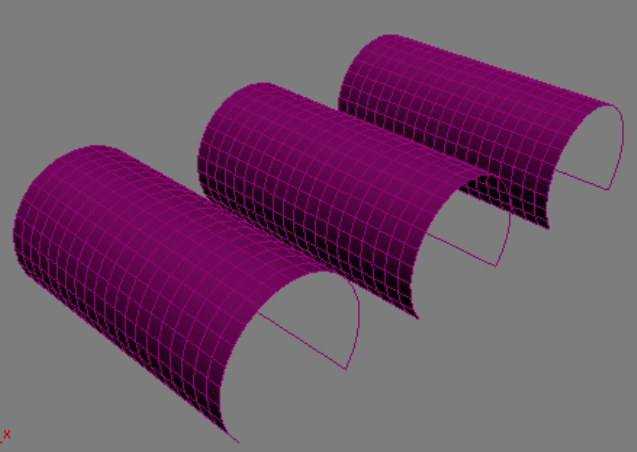
Procedures
Example: To use the Keep Shape option:
If your cloth object starts out with 3D shape that you'd like to retain during
the simulation, you can use the Keep Shape option and setting to preserve
this shape, or even reverse it. This simple procedure provides an example of
how to use Keep Shape.
1In the Top or Perspective viewport, add a Plane primitive object of about
90 x 90 units, with 20 x 20 segments.
2Apply a Bend modifier, set Angle to 250.0, and set Bend Axis to X.
This produces the initial tubular shape.
3Copy the bent plane twice so you have three planes in a row. Rename
the planes as follows:
■don't keep shape
■keep shape
■reverse shape
4Select all three planes and apply the Cloth modifier.
1182 | Chapter 9 Modifiers

5On the Simulation Parameters rollout, turn off Gravity and set cm/unit
to 0.5.
Turning off Gravity keeps the cloth objects from falling during the
simulation, so they stay in view, and lowering the cm/unit setting
compensates for the planes' relatively large size.
6On the Object rollout, click Object Properties.
This opens the Object Properties dialog.
7In the Objects In Simulation list, highlight all three planes (by dragging),
and then, above the Cloth Properties group, choose Cloth. Also set U
Bend to 500.0.
This sets V Bend also to 500.0 automatically.
Using high Bend values allows the simulation to proceed more quickly.
Next, you'll set different Keep Shape properties separately for each object.
8Highlight the reverse shape object in the list and set the Bend % value to
-100.0.
NOTE The default value was 100.0.
9Click OK to exit the dialog.
10 Select the don't keep shape object and note that Object rollout > Selected
Objects Manip group > Use Target State is off.
11 Select both the reverse shape and the keep shape objects, but not don't keep
shape, and then turn on Use Target State.
12 On the Object rollout, click Simulate Local.
Cloth and Garment Maker Modifiers | 1183
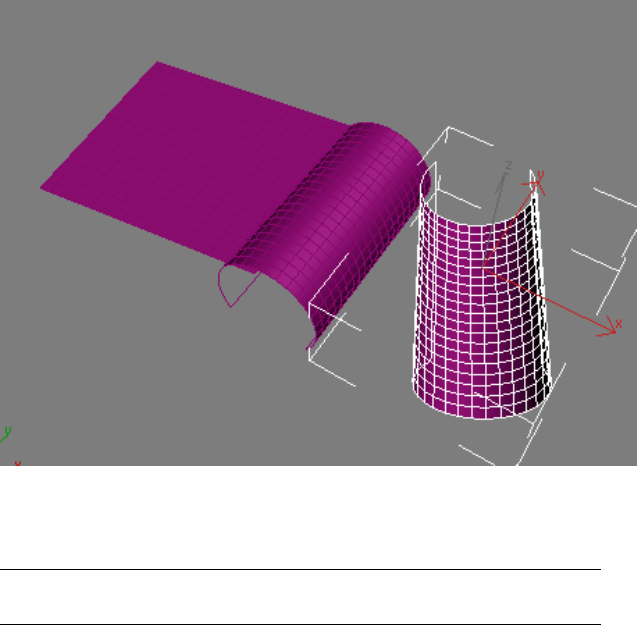
After a few seconds, the don't keep shape object starts to flatten out, the
keep shape object doesn't change, and the reverse shape object has, in fact,
reversed its shape, effectively creating a negative bend angle.
TIP You can also use Use Target State with Grab State to maintain or reverse
a shape created with a previous cloth simulation or shape-changing modifier.
To run a cloth simulation with a networked render farm:
A complex cloth simulation can require extensive computation and take a
long time. Cloth includes commands that make it easy to run a simulation
on a networked machine (part of a render farm), freeing up your machine for
working on other parts of the scene.
1Set up the simulation.
2For each cloth object in the simulation, select the object, and then on
the Selected Object rollout click Set and specify a path and file name for
the cache.
For best results, specify a mapped drive and turn on Force UNC Path.
This specifies the path using the Universal Naming Convention so that
1184 | Chapter 9 Modifiers

it can be found by all computers in the network. Also, it's probably a
good idea to keep all the cache files in the same directory.
3On the Simulation Parameters rollout, turn on Sim On Render.
4Save the scene file.
5On the Render Scene dialog, turn on Net Render, and then click Render.
Submit the job to a single Server.
Unlike rendering, network Cloth simulation cannot be split up among
multiple Server machines.
NOTE You needn't render the entire animation to trigger the cache creation;
a single frame suffices.
As soon as the Server machine starts the render, it begins computing the
simulation and saving it to disk. At any point you can load the simulation
in its current state from the cache file to check its progress by clicking
the Load button.
Interface
The Cloth interface varies depending on the current modifier stack level:
Object on page 1185 or one of the four sub-object levels:
■Group on page 1198
■Panel on page 1211
■Seams on page 1217
■Faces on page 1218
Object rollout
The Object rollout is the first rollout you see on the Command panel once
you apply the Cloth modifier. It comprises mostly controls to create a Cloth
simulation and adjust fabric properties.
Cloth and Garment Maker Modifiers | 1185

Object Properties Opens the Object Properties dialog on page 1219 , where
you can define which objects to include in the simulation, whether they are
cloth or collision objects, and the parameters associated with them.
1186 | Chapter 9 Modifiers
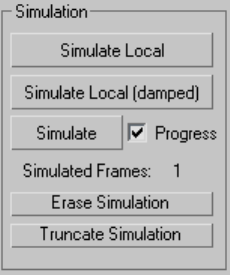
Cloth Forces Add forces (that is, space warps in the scene) such as wind to
the simulation. Click Cloth Forces to open the Forces dialog. To add forces to
the simulation, in the Forces In Scene list on the left side, highlight the forces
to add, and then click the > button to move them to the Forces In Simulation
list, thus adding them to the simulation. Thereafter, the forces affect all cloth
objects in the simulation.
To remove forces from the simulation, in the Forces In Simulation list on the
right side, highlight the forces to remove, and then click the < button to move
them to the Forces In Scene list.
Simulation group
To run a cloth simulation, click any of the three Simulate buttons in this
group. To halt a simulation, press Esc or if the Cloth Simulation dialog is open
(i.e., Progress on page 1188 is on), click the Cancel button.
Simulate Local Starts the simulation process without creating animation.
Use this to drape the clothes on a character or sew the panels of a garment
together.
Simulate Local (damped) Same as Simulate Local, but with a large amount
of damping added to the cloth. When sewing a garment together, sometimes
the panels come together at high speed, causing problems. Using a damped
simulation alleviates this problem.
Simulate Creates a simulation over the active time segment. Unlike Simulate
Local, this creates animation data in the form of a simulation cache at every
frame.
The simulator advances by a time step called dT. The initial value is the Step
setting on page 1196 on the Simulation Parameters rollout. When the simulator
encounters certain situations, it decreases dT in order to overcome the
Cloth and Garment Maker Modifiers | 1187
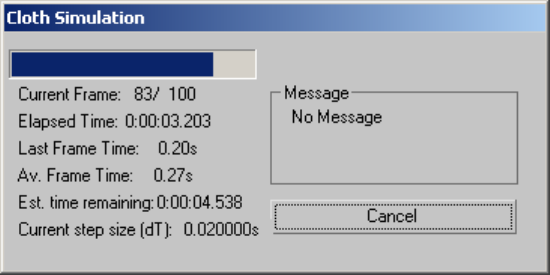
obstacles. Sometime later, the simulator increases dT again up to the maximum
Step value you set. The current value of dT appears on the Cloth Simulation
dialog that shows the progress of the simulation as it takes place (see following).
When the simulator decreases dT, it shows "dT decreased" on the Cloth
Simulation dialog along with one of the following messages (explanation
follows each message):
■could not solve equations – The solver could not solve the equations of
motion.
■cloth has become over-stretched – In attempting to solve one step, some
edges of the cloth became too elongated, indicating a failure of the solver.
■cloth-solid collision velocity was too large – The speed of the cloth relative
to that of the collision object is too high.
■cloth-cloth collision velocity was too large – The speed of colliding cloth
parts is too high.
Progress When on, opens the Cloth Simulation dialog during the simulation.
The dialog shows the progress of the simulation, including information about
time, and messages about errors or time step size adjustments.
The Cloth Simulation dialog shows information about the simulation while it's running.
Simulated Frames Shows the number of frames simulated so far.
Erase Simulation Deletes the current simulation. This deletes the cache of
all cloth objects and sets the Simulated Frames count back to 1.
Truncate Simulation Deletes animation created by the simulation after the
current frame.
1188 | Chapter 9 Modifiers
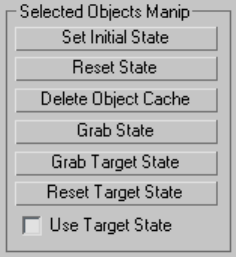
For example, if you've simulated an animation to frame 50 but want to keep
only animation keys from frames 0 to 30, set the time slider to frame 30, then
click this button. The simulation is then deleted from frame 31 on.
Selected Object Manip group
Set Initial State Updates the first frame of the selected cloth object’s cache
to the current position.
Reset State Resets the selected cloth object's state to the state before Cloth
in the modifier stack. When you click this, the simulation is erased; that is,
Simulated Frames returns to 1.
Delete Object Cache Deletes the cache for selected non-cloth objects. If an
object is simulated as cloth, and is then turned into a collision object (or
inactive) via the Object Properties dialog, it will retain the cloth motion in its
cache.
This is useful for simulating clothes in layers. For example, you may simulate
a character’s pants, then turn the pants into a collision object for simulating
a coat. By simulating in layers, you avoid the problems of cloth-to-cloth
collision detection. If you want to remove the cached motion from the selected
object(s), click this button.
Grab State Grabs the current state from the top of the modifier stack and
updates the cache for the current frame.
Following is an example of how this might be used:
1Simulate to frame 100. When you play back the simulation, you see a
collision object poking through the cloth at frame 24.
2Add an Edit Mesh modifier after Cloth and pull the cloth vertices so the
object doesn't poke through.
Cloth and Garment Maker Modifiers | 1189
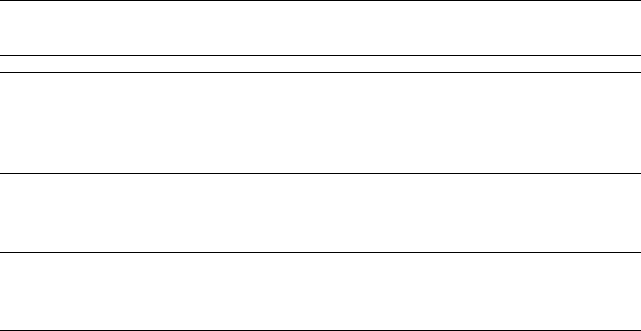
3Go down the stack to Cloth and click Grab State. The vertices are now
moved twice as far as you intended because the vertex displacement was
applied once by Cloth, and again with Edit Mesh.
4Remove the Edit Mesh modifier. The vertices should now be where you
want them.
Grab Target State Lets you specify the target shape for Keep Shape on page
1226 . Grabs the current deformation from the top of the modifier stack and
uses that mesh to define the target bend angles between triangles. Also turns
on Use Target State on page 1190 .
NOTE Only the bend angles from the Target State mesh are used, not the edge
lengths.
TIP To add some natural creasing to your cloth, drop the cloth on the floor, click
Grab Target State, and then run the simulation. After clicking Grab Target State
and before running the simulation, click Reset State (unless you want the cloth to
stay on the floor!).
Reset Target State Resets the default bend angles to the mesh below Cloth
in the stack.
NOTE For Garment Maker on page 1228 objects, the target bend angles will depend
on the output method set in the Garment Maker modifier. To see what is actually
being used, use Show Target State on page 1191 .
Use Target State When on, preserves the shape of the mesh as stored by
Grab Target State on page 1190 . It uses the Bend % and Stretch % settings in
the Keep Shape on page 1226 group on the Object Properties dialog for Cloth.
If multiple cloth objects with different Use Target State settings are selected,
this check box appears unavailable, but you can click it to make the setting
for all selected objects.
1190 | Chapter 9 Modifiers
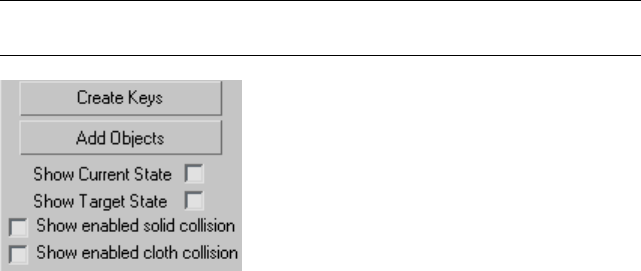
NOTE In previous versions, this check box was labeled Keep Shape and was found
on the Object Properties dialog for Cloth.
Create Keys Creates keys for a selected cloth object. The object is collapsed
to an editable mesh, and any deformation is stored as vertex animation.
Add Objects Lets you add objects to the simulation without opening the
Object Properties dialog. Click Add Objects, and then click an object to add.
To add multiple objects at once, press H and use the Pick Objects dialog.
Show Current State Shows the current state of the cloth at the end of the
last simulation time step.
If the simulation is cancelled, the last time step could lie between two frames.
If the simulation is allowed to successfully finish, the last time step corresponds
to the last frame.
Show Target State Shows the current target state of the cloth; that is, the
desired bend angles used by the Keep Shape option.
Show enabled solid collision When on, highlights all groups of vertices for
which Solid Coll on page 1203 is on. This is handy for seeing exactly which
vertices will be involved in solid-object collisions.
Show enabled self collision When on, highlights all groups of vertices for
which Self Coll on page 1203 is on. This is handy for seeing exactly which
vertices will be involved in cloth-to-cloth collisions.
Selected Object rollout
The Selected Object rollout lets you control the simulation caches, control
and optionally animate the cloth properties with a texture map or
interpolation, and specify a bend map. This rollout appears only when a single
object in the simulation is selected.
Cloth and Garment Maker Modifiers | 1191

Cache group
Use these settings for network simulation. When you render with Sim On
Render on page 1197 on, Cloth can run the simulation on a networked machine,
1192 | Chapter 9 Modifiers
leaving your local machine free for other work. For a procedure, see To run
a cloth simulation with a networked render farm: on page 1184 .
[text field] Shows the current path and file name for the cache file. You can
edit this field, but the path must exist; the file will be created if necessary.
For any cloth object for which you have not specified a file name, Cloth creates
one based on the object name.
Force UNC Path If the text field path is to a mapped drive, converts the path
to UNC format on page 7961 . This makes the path readily accessible to any
computer on the network. To convert cache paths for all cloth objects in the
current simulation to UNC format, click the All button.
Overwrite Existing When on, Cloth can overwrite existing cache files. To
enable overwriting for all cloth objects in the current simulation, click the All
button.
Set Lets you specify the path and filename of the cache file for the selected
object. Click Set, navigate to the directory, enter the file name, and then click
Save.
Load Loads the specified file into the selected object's cache.
Import Opens a file dialog to load a cache file other than the specified one.
Load All Loads the specified cache file for every cloth object in the simulation.
Save Saves the current cache, if any, using the specified file name and path.
If no file is specified, Cloth creates one based on the object name.
Export Opens a file dialog to save the cache to a file other than the specified
one. You can save in the default CFX format or in PointCache2 format.
Extra Cache To create a second cache in PointCache2 format, turn on Extra
Cache and click Set to specify a path and file name. This file is also created
when you render with Sim On Render on.
Property Assignment group
Interpolate Interpolates between the two different property settings in the
Object Properties dialog on page 1219 (as determined by the Property 1 and
Property 2 radio buttons at the top right corner). You can use this slider to
animate between these two properties to adjust the type of fabric settings the
garment is using.
Texture Map Set a texture map and apply the Property 1 and Property 2
settings to the cloth object. You can add a grayscale texture map in this slot
to blend between the two properties set in the Object Properties dialog. Black
Cloth and Garment Maker Modifiers | 1193
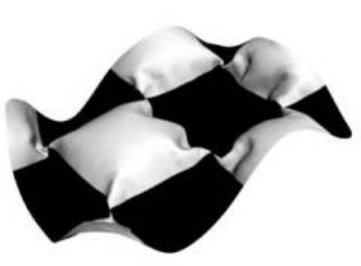
will represent property 1 and white property 2. Any grayscale value will blend
between these two properties. You can drag a texture map onto this button.
Cloth object with a burlap material in Property 1 and silk in Property 2 being controlled
by a Checker procedural map
Mapping Channel Lets you specify the mapping channel the Texture map
will work from, or choose Vertex Color to use that instead. Vertex color can
be particularly useful in conjunction with the new painting tools in 3ds Max.
You can paint vertex colors directly onto your object and use the painted areas
for material assignment.
Bend Map group
The Bend Map option lets you use a texture map, map channel, or vertex
colors to modulate the target bend angles. The value of this is that you can
paint deformations onto your cloth, or use some kind of noise map to add
irregularity to the cloth.
Bend Map Toggles the use of the Bend Map option.
Set the strength of the modulation with the numeric value. In most cases, the
value should be less than 1.0. Range=0.0 to 100.0. Default=0.5.
[map type] Choose the map type for the Bend map:
■Vertex Color Uses the Vertex Color channel for modulation.
■Map Channel Uses a map channel other than Vertex Color for
modulation. Set the channel with the spinner.
■Texture Map Uses a texture map for modulation. To specify a texture
map, click the button (labeled None by default) and then use the
Material/Map Browser to choose the map. Thereafter the map name appears
on the button.
1194 | Chapter 9 Modifiers
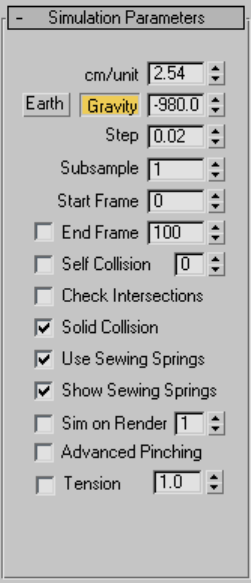
Simulation Parameters rollout
The Simulation Parameters rollout settings let you specify general properties
of the simulation such as gravity, start and end frames, and sewing-spring
options. These settings apply to the simulation on a global scale, that is, to
all objects in the simulation.
cm/unit Determines how many centimeters there are per 3ds Max system
unit.
Cloth automatically sets cm/unit to the equivalent of 2.54 centimeters per
inch (the default system unit in 3ds Max). For example, if you set the system
unit to one foot, Cloth automatically sets cm/unit to 30.48 (12x2.54).
Size and scale are important when doing cloth simulation because a 10-foot
curtain behaves much differently from a one-foot square handkerchief, even
if they are made from the same fabric.
Earth Click this button to set the Gravity value to that of planet Earth.
Cloth and Garment Maker Modifiers | 1195
Gravity When on, the Gravity value (see following) affects cloth objects in
the simulation.
[Gravity value] The force of gravity in cm/sec2. A negative value applies
gravitational force downward. A positive value (i.e., no sign) means gravity
will act to move cloth objects upward. The default value is set to be the same
as Earth's gravity: -980.0 cm/sec2.
Step The maximum size of the time step the simulator takes.
This value is measured in seconds. The value must be less than the length of
one frame (less than 0.033333 for 30 fps animation). A value of 0.02 is generally
the largest value you want to use. Reducing this value causes the simulator to
take longer to calculate, but will in general give better results. The simulator
will automatically reduce its time steps as needed, but this is the maximum
value that it will try. This value works in conjunction with the Subsample
parameter: The actual maximum value=Step value divided by Subsampl value.
Subsample The number of times per frame that the software samples the
position of solid objects. Default=1.
At the default value, Cloth samples the solid objects in the simulation once
every frame. Increasing this value should help when objects are moving or
rotating quickly, but be aware that the higher you set the value, the slower
the simulation will be.
Start Frame The frame at which the simulation starts. If you change this
value after the simulation has been performed, the cache will be moved to
this frame. Default=0.
End Frame When on, determines the frame at which the simulation will
stop. Default=100.
Self Collision When on, detects cloth-to-cloth collisions. Leaving this off
will speed up the simulator, but will allow cloth objects to interpenetrate.
The numeric setting specifies the extent to which Cloth tends to avoid
self-colliding cloth objects, at the cost of simulation time. Range=0 to 10.
Default=0.
This is a maximum limit. If Cloth needs fewer calculations to resolve all
collisions, it will use fewer. In most cases, a value greater than 1 isn't necessary.
Check Intersections (Discontinued feature. This check box has no effect.)
Solid Collision When on, the simulator takes into account cloth-to-solid
object collisions. This is almost always left on.
Use Sewing Springs When on, uses the sewing springs created with Garment
Maker to pull the fabric together.
1196 | Chapter 9 Modifiers

This works only with objects that have been made with Garment Maker on
page 1228 . Turn this option off once the garment has been pulled together.
When off, Cloth will identify vertices that are sewn together and will always
keep them coincident. When on, there is always a chance for the vertices to
come apart if the sewing springs are not strong enough (actually, there will
always be some slight gap between the vertices in this case).
Show Sewing Springs Toggles the visual representation of the sewing springs
in the viewports. These do not render.
Sim on Render When on, triggers the simulation at render time. Use this
for generating a simulation with a network computer, which lets you continue
to work on other aspects of your scene with your own computer. See a
procedure here on page ? .
After the render is completed, Cloth writes a cache for each cloth object. You
can specify this cache file on the Selected Object rollout on page 1191 (which
is available only when a single object is selected). If you do not specify a name,
the software creates one.
The numeric value indicates the priority of the simulation; the simulations
are run in ascending order. For modifiers with the same priority, the order is
undefined.
NOTE Each object has its own cache file, which is temporarily created when the
MAX file is opened. On saving the file, the cache is incorporated into the MAX
file. When Sim On Render is on, the cache file specified is created and written to,
but is not read from as you change the time slider. The cache file must be loaded
into the internal cache file on page 1193 before you can see it.
Advanced Pinching When on, Cloth tests for cloth pinched between two
parts of the same collision object.
This option helps with cloth colliding with small features of the collision
objects, such as fingers. There is a significant performance hit for
high-resolution collision objects.
Tension Lets you visualize the compression/tension in the fabric by means
of vertex coloring. Stretched cloth is indicated by red, compressed by blue,
neutral by green. The numeric setting lets you change the range of
tension/compression illustrated by a complete traversal from red to blue. The
higher this value, the more gradual the shading. This works only for Garment
Maker objects.
Cloth and Garment Maker Modifiers | 1197
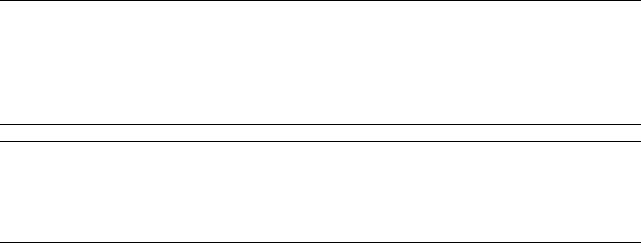
Group rollout
The Group sub-object rollout is for selecting groups of vertices and constraining
them to surfaces, collision objects, or other cloth objects. At the Group
sub-object level, all selected objects that are part of the Cloth simulation are
shown with their vertices visible so that you can select them in an efficient
fashion.
When you create or select a group at this sub-object level, the Group Parameters
rollout becomes available.
IMPORTANT The concept of a group for Cloth can be applied to both the cloth
objects and to the collision objects in the simulation. And when created, groups
can then be given unique properties. For example, a group on a collision object
can have a different collision offset from the rest of the object. This is a powerful
feature when working with groups.
NOTE You can select groups of vertices explicitly, with the mouse in the viewports,
and you can also specify a soft selection or use a texture map to select vertices
using controls on the Group Parameters rollout. See Soft Selection group on page
1210 . In addition, named selection set on page 179 tools are available at this level.
1198 | Chapter 9 Modifiers
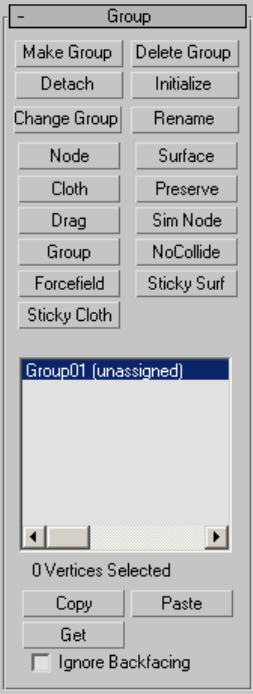
Make Group Makes a group out of selected vertices. Select the vertices to
include in the group, and then click this button. Name the group, and it will
then show up in the list below for you assign to an object.
Delete Group Deletes the group highlighted in the list.
Detach Removes any constraint assigned to the group and sets it back to
being unassigned (i.e., without any constraint). Any unique properties assigned
to this group will remain in effect.
Initialize Constraints that involve attaching the vertices to another object
(Node, SimNode, Surface and Cloth constraints) contain information regarding
the relative positions of the group vertices to the other object. This information
Cloth and Garment Maker Modifiers | 1199
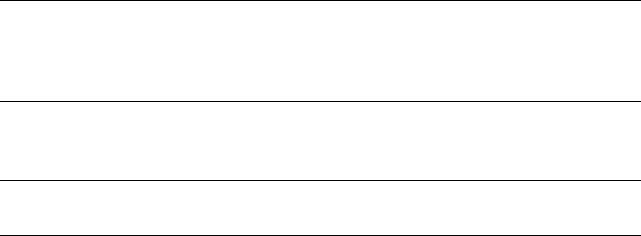
is created upon the creation of the constraint. To regenerate this information,
click this button.
Change Group Lets you modify the vertex selection in the group. To use,
follow this procedure:
1Choose the group in the list.
2Change the selection of vertices.
3Click Change Group.
Rename Renames the highlighted group.
Node Constrains the highlighted group to the transforms of an object or
node in the scene. To use, click Node, and then select the node for
constraining. The node cannot be an object in the simulation; for that purpose,
use the SimNode constraint on page 1201 .
NOTE Node and SimNode simply constrain the group to an object's transforms
, not to the object itself. They need not be near each other. When the cloth and
the constraining object should be in close proximity, such as with clothing on a
character mesh, use the Surface constraint instead (see following).
Surface Attaches the selected group to the surface of a collision object in
the scene. To use, click Surface, and then select the node for attaching.
TIP This constraint is best suited for when the cloth and the constraining object
should be in close proximity, such as with clothing on a character mesh.
Cloth Attaches the selected group of cloth vertices to another cloth object.
Preserve This group type preserves the motion from below the Cloth modifier
in the modifier stack. For example, you might have a dress that you've skinned
to a skeleton. You want the upper portion of the dress to be unaffected by the
Cloth simulation (that is, to retain its deformation defined by the skinning),
and the lower part to be simulated. In this case, you'd make a Preserve
constraint from the upper vertices.
Drag This group type locks the vertices in place or adds a damping force to
selected group. When Group Parameters rollout > Soft on page 1202 is off, you
can use this constraint for “nailing” vertices in place so that they do not move
at all. When Soft is on, the vertices will have a drag force applied where the
amount of drag is controlled by the Strength and Damping values, also on
the Group Properties rollout.
1200 | Chapter 9 Modifiers
SimNode This option works the same as the Node option on page 1200 ,
except the node must be part of the Cloth simulation.
Group Attaches one group to another. This is recommended only for
single-vertex groups. (that is, groups that contain only one vertex). With this,
you can make one cloth vertex stick to another cloth vertex. Select one group,
click this button to open the Pick Group dialog , and then choose another
group.
NoCollide Causes collisions between the currently selected group and another
group to be ignored. When you click this button, you're prompted to choose
another group. You could use this option to prevent the simulator from
processing collisions between cloth and the body under an arm or between
the legs.
Forcefield Allows you to link a group to a space warp and have the space
warp affect the vertices.
Sticky Surf The group sticks to a surface only after it has collided with that
surface. Solid Coll on page 1203 must be enabled for this constraint to work.
Sticky Cloth The group sticks to a surface only after it has collided with that
surface. Self Coll on page 1203 must be enabled for this constraint to work.
[group list] Shows all current groups. The number of vertices associated with
the highlighted group is shown below the list. To assign, copy, paste, delete
or alter a created group, first highlight the group name in the list.
Copy Copies a named selection set to the copy buffer.
Paste Pastes the named selection set from copy buffer.
Group Parameters rollout
The Group Parameters rollout appears after you use Make Group on a vertex
selection to create at least one group. Thereafter, highlight the group in the
Group rollout list to display and edit the group's settings with the Group
Parameters rollout.
Cloth and Garment Maker Modifiers | 1201
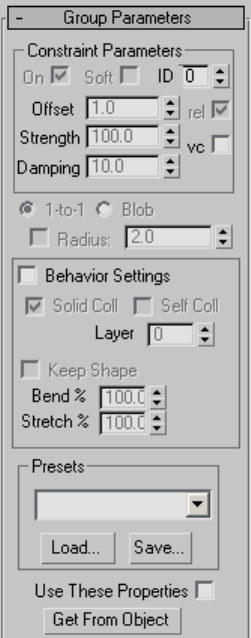
Constraint Parameters group
On When on, enables the constraint specified for the current group in the
group list on the Group rollout, using remaining settings in this group box.
Soft Sets the constraint type to soft. A soft constraint uses springs between
vertices. When off, the constraint is hard or rigid. The constraint types Node,
Surface, Preserve, Drag, and SimNode can be hard or soft. Cloth, Group, and
Forcefield constraints are always soft.
ID Uses a Material ID to attach the group to an object. This option applies
only to Surface and Cloth constraints. If, when the constraint is created or
initialized, the cloth vertices are not over a triangle, then the constraint will
be created to the center of the nearest triangle that has the requisite Material
ID. This could mean that several vertices might be constrained to the center
of the same triangle. In this case, you should only use soft constraints. A hard
1202 | Chapter 9 Modifiers
constraint would pull all those cloth vertices to the same exact point on the
triangle, which would look strange.
Offset The variance in the distance between a constrained group and its
constraining, or target, object. The default value is 1.0 with Rel. on page 1203
on. This sets the constrained group to maintain its original distance from the
target object. When set to 0.0, the constraint seeks to set the distance to the
target object to zero.
Strength The stiffness of the springs used if the constraint is soft.
Damping The damping of the springs if the constraint is soft.
Rel. Specifies the offset as a ratio of the original value. Available only with
the Surface and Cloth constraint types. For example, if you want to move a
constrained vertex by half its original distance, turn on the Rel. check box
and set Offset to 0.5.
Vc Sets vertex colors to determine the strength of the constraint.
1-to-1 When the mesh density is changed in Garment Maker, the group
selection is reassigned. The 1-to-1 option selects the vertex closest to the
original vertex.
Blob When the mesh density is changed in Garment Maker, the group
selection is reassigned. The Blob option selects the original vertex and the
ones created within a certain radius of it. The radius can be left at default or
auto, or it can be set manually.
Radius When on, lets you set the radial distance used by the Blob option
(see preceding). When off, Blob uses an automatic radial value.
Behavior Settings group
Behavior Settings Toggles the availability of the other settings in this group.
When off, the other settings have no effect.
Solid Coll When on, the group vertices are used in solid-collision detection.
Self Coll When on, the group vertices are used in self-collision detection.
Layer Indicates the correct "order" of cloth pieces that might come in contact
with each other. Range=-100 to 100. Default=1.
If your garments and/or panels are all correctly orientated to begin with, then
cloth-to-cloth collision detection should keep items from interpenetrating.
However, the initial state of a garment/panel might have some interpenetration
that cannot be resolved. For example, suppose you make a jacket with Garment
Maker where the front right panel is supposed to sit on top of the front left
Cloth and Garment Maker Modifiers | 1203
panel. When you sew together the garment (generally with self-collision off),
the front panels will interpenetrate, so to make sure that the right panel sits
outside the left panel, you might have to use constraints or Live Drag. Using
the Layers option on the panels can help here.
Here is the logic of layers: When two pieces of cloth (A and B) are in
collision-detection range, their layers (layerA and layerB) are compared and
the following rules are applied:
■If either layerA or LayerB is 0, then Cloth uses the regular cloth-to-cloth
collision method.
■If layerA=layerB, then Cloth uses the regular cloth-to-cloth collision
method.
■If abs(layerA) > abs(layerB) then piece A is pushed to the appropriate side
of piece B. Which side? If layerB > 0, then to the side indicated by the face
normals. If layerB<0 then to the opposite side.
The sign of the Layer value indicates what the "outside" of that piece of cloth
is. A positive sign means "The side that the normals face is the outside".
Keep Shape When on, preserves the shape of the mesh based on the Bend
% and Stretch % settings (see following). In normal operation, when Cloth
creates a simulation, it tries to "flatten out" the cloth.
Bend % Modulates the target bend angles to a value between 0.0 and the
angles defined by the target state on page 1190 . A negative value inverts the
angles. Range=-100.0 to 100.0. Default=100.0.
Stretch % Modulates the target stretch angles to a value between 0.0 and
the angles defined by the target state on page 1190 . A negative value inverts
the angles. Range=-100.0 to 100.0. Default=100.0.
Presets group
Sets the Cloth Properties parameters to the preset selected in the drop-down
list. Any presets that are built into the system or that have been loaded will
show up here.
Load Loads presets from the hard drive. Click this button and then navigate
to the directory with your presets to load them into your Cloth Properties.
1204 | Chapter 9 Modifiers

Save Saves your Cloth Properties parameters to a file that you can then load
at a later time.
Use These Properties Determines the cloth properties from the settings on
the rollout below.
Get From Object Sets the cloth properties of the group to be the same as the
object they are selected on.
Cloth and Garment Maker Modifiers | 1205
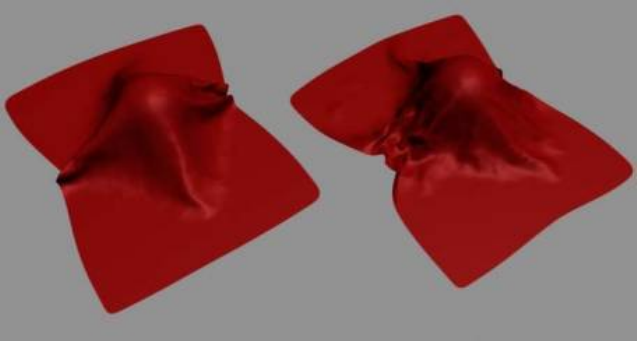
U Bend/V Bend Resistance to bending. The higher this value is set, the less
the fabric will be able to bend. A cotton fabric might bend more easily than
leather, so a value of 15.0 for both U and V Bend might be good for cotton,
while 50.0 would work well for leather.
By default, the U Bend and V Bend parameters are locked together so that
changing one sets the other to the same value. You can set different values
for the two only when Anisotropic on page 1210 is off. It is recommended to
do this only for Garment Maker on page 1228 objects.
Left: U and V Bend=50, simulating a burlap material
Right: U and V Bend=2.5, simulating silk or other light fabric
U B-Curve/V B-Curve Resistance to bending as the fabric folds. The default
value of 0 sets the bend resistance to be constant. A setting of 1 makes the
fabric very resistant to bending as the angle between triangles approaches 180
degrees. You never want two adjacent triangles to pass through each other,
so you can increase this value to prevent this from happening.
By default, the U B-Curve and V B-Curve parameters are locked together so
that changing one sets the other to the same value. You can set different values
for the two only when Anisotropic on page 1210 is off. It is recommended to
do this only for Garment Maker on page 1228 objects.
U Stretch/V Stretch Resistance to stretching. The default value of 50.0 is a
reasonable value for most types of cloth. A larger value will be stiffer, while a
smaller one will be stretchy like rubber.
By default, the U Stretch and V Stretch parameters are locked together so that
changing one sets the other to the same value. You can set different values
1206 | Chapter 9 Modifiers

for the two only when Anisotropic on page 1210 is off. It is recommended to
do this only for Garment Maker on page 1228 objects.
U Compress / V Compress Resistance to compression. Although
these values default to 50.0, like their counterpart Stretch values, assigning
values lower than the Stretch values can give good results, because when cloth
is compressed along the length of its fibers, it tends to buckle rather than
shrink.
By default, the U Compress and V Compress parameters are locked together
so that changing one sets the other to the same value. You can set different
values for the two only when Anisotropic on page 1210 is off. It is recommended
to do this only for Garment Maker on page 1228 objects.
Shear Resistance to shearing. Higher values result in stiffer cloth fabrics.
Shear defines how much the individual triangles can deform. If you were to
lay the edges of the triangle out in a strait line this value would represent how
long this line can stretch out to. With a high value this length will only be
the sum of the length of all of the sides at rest. A low value will allow this
length to be greater then that off all of its sides at rest. This length of stretched
sides is not on a one to one basis. One side of the polygon may stretch more
then another as long as the total shear value is not exceeded.
Density The weight of the cloth per unit area (in gm/cm2). Higher values
mean heavier cloth like denim. Use smaller values for lighter cloth like silk.
Thickness Defines the virtual thickness of a fabric for the purpose of detecting
cloth-to-cloth collisions. This value is irrelevant if cloth-to-cloth collisions are
disabled. Larger values keep the cloth separated by greater distances. Be careful
not to use too large or small values in this field. Very large values will interfere
with the natural behavior of the cloth. Very small values will cause the
simulator to take too long to calculate. This distance is measured in cm
(centimeters) and should be smaller than the size of the triangles that make
up the cloth object. A setting of 0.0 will let Cloth automatically assign a
reasonable value for thickness.
Cloth and Garment Maker Modifiers | 1207
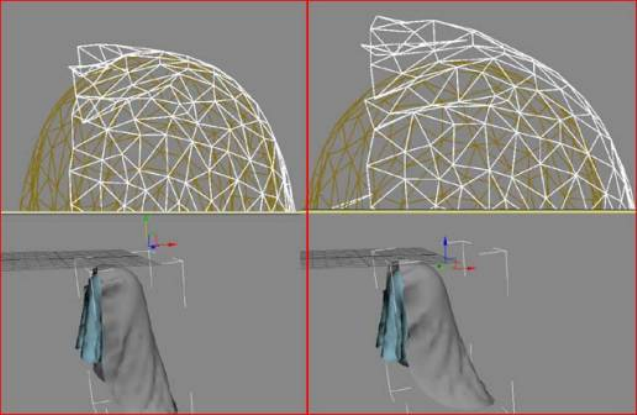
Left: The top piece of cloth with a Thickness of 0
Right: Thickness of 9
Repulsion The amount of force used to repel other cloth objects. This value
is irrelevant if cloth-to-cloth collisions are disabled. The simulator will apply
a repulsion force scaled by this value to keep the cloth from coming in contact
with other cloth objects. Increase this value if there are a lot of collisions
between different parts of cloth, or if the cloth is tending to interpenetrate.
Damping The larger this value, is the more sluggishly the fabric will react.
With a lower value, the fabric will behave with more spring. Cloth with more
damping will come to rest sooner then cloth with less damping. High damping
results in cloth that behaves as though it is moving through oil. Excessive
damping may also cause simulation instabilities. A good value is the default,
0.01.
Air Res. Resistance to Air. This value will determine how much the air will
effect the cloth. A higher amount of air resistance would be useful for a tightly
woven fabric, while a lower amount would be suitable for a loose-knit garment.
Dyn. Fric. Dynamic friction between the cloth and solid objects. A larger
value will add more friction and cause the fabric to slide less across an object.
A lower value will allow the fabric to slip off an object very easily, similarly
to how silk would react.
1208 | Chapter 9 Modifiers
Static Fric. Static friction between the cloth and solid objects. When the
cloth is in stationary position, this value will control its ability stay where it
is, or slip away.
Self Fric. Friction between the cloth and itself. This is similar to dynamic
and static friction, but applies to cloth-to-cloth or self-collisions. A larger value
will cause more friction between the cloth and itself.
U Scale Controls how much to shrink or expand the cloth along the U
direction (as defined by Garment Maker. For non-Garment Maker meshes,
this applies a uniform scaling to the cloth along both axes, and the V Scale
parameter is ignored). A value of less than 1 will shrink the fabric at simulation
time, while a value of more than 1 will stretch it.
V Scale Controls how much to shrink or expand the cloth along the V
direction (as defined by Garment Maker). A value of less than 1 will shrink
the fabric at simulation time, while a value of more than 1 will stretch it.
Seam Force Not presently used and only kept for backward compatibility
with older versions of the former product called Stitch. This was a global seam
strength, but seam strength is now defined on a seam-by-seam basis in the
Seams sub-object Mode.
Depth Collision depth. If a portion of cloth reaches this depth inside a
collision object, then the simulation will no longer try to push the cloth out
of the mesh. This value is measured in 3ds Max units.
Offset The amount of distance kept between the cloth and the collision
object. A very low value can cause the collision mesh to protrude out from
under the cloth. A very high value will cause the fabric to look as if it is floating
on top of the collision object.
Plasticity The tendency of the cloth to keep its current deformation (that is,
the bend angles).
This is different from Keep Shape on page 1226 , which determines the extent
to which the cloth tends to keep its original deformation (or the one defined
by the Target State). If you set Plasticity to 100.0, the cloth will not attempt
to change the angles between triangles. If you want stiffer cloth, but you don't
want the cloth to "balloon" up, increase the Plasticity value.
Cling The extent to which the cloth object adheres to a collision object.
Range=0.0 to 99999.0. Default=0.0.
You can use this parameter to simulate effects such as wet cloth. A setting of
1.0 should be just enough to hold the default material onto a surface against
its own weight.
Cloth and Garment Maker Modifiers | 1209
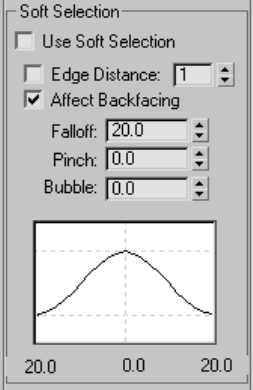
Based on Displays the preset that the group properties are based on. When
you modify parameters and save a preset, Cloth uses the name of the last
preset you loaded as the “Based on” name.
Anisotropic When on, you can set different U and V values for the Bend,
B-Curve, and Stretch parameters. The U and V directions are defined by
Garment Maker on page 1228 and do not apply to non-Garment Maker meshes,
for which setting different U/V values might result in unexpected behavior.
Use Edge Springs This is an alternative method for calculating stretch. When
this option is on, stretch force is based on springs along triangle edges.
(Whereas normally the stretch and shear forces are calculated in a more
sophisticated manner to more accurately reflect the underlying physics).
Use Cloth Depth/Offset Uses the Depth and Offset on page 1209 values set
for the group. When on, the cloth object ignores the collision object Depth
and Offset values.
Soft Selection group
The Soft Selection controls apply on a per-group basis to permit soft selection
of vertices neighboring the explicitly selected group members. This works the
same as soft selection of vertices in other parts of 3ds Max. For details, see
Soft Selection Rollout on page 1926 . Alternatively, you can select vertices for a
group based on a texture map.
1210 | Chapter 9 Modifiers
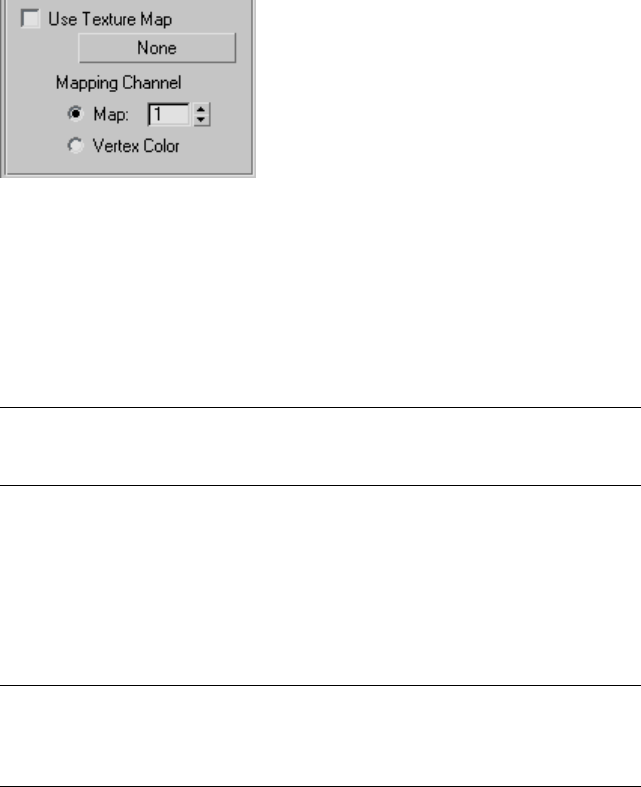
Use Texture Map When on, Cloth uses a texture map to specify a soft
selection of vertices that belong to the current group. Click the button (by
default, labeled “None”) to choose a texture map. Use the Mapping Channel
controls to choose a map channel or vertex color channel.
You can add a grayscale texture map in this slot to blend between unselected
and fully selected pixels in the group. Black represents unselected and white
represents fully selected. Any grayscale value blends between the two. You
can drag a texture map onto this button.
NOTE For a texture map to apply to a group, at least one vertex must be explicitly
selected. However, when Use Texture Map is on, the group's explicit vertex
selection has no effect.
Panel rollout
At the Panel sub-object level, you can select one panel (cloth section) at a time
and change its cloth properties. A panel, which must be created by the
Garment Maker modifier on page 1228 , is a closed spline that is not enclosed
by another spline. If a closed spline is enclosed by another spline, it forms a
hole in the outer spline.
NOTE To be able to select a panel at this sub-object level, you must first use
Object Properties on page 1219 to specify that the object is cloth. Also, to be able
to change settings on this rollout, first turn on Object Properties > Use Panel
Properties on page 1221 .
Cloth and Garment Maker Modifiers | 1211
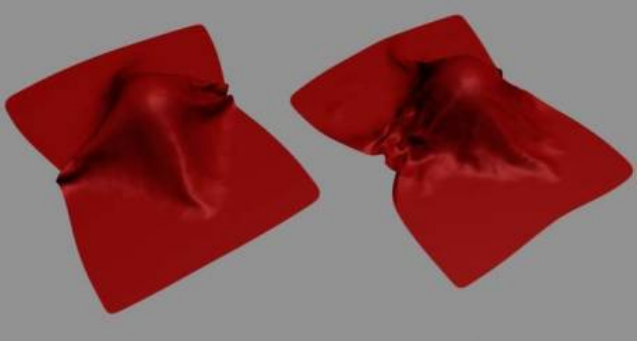
Presets group
Presets Sets the selected panel's properties parameters to the preset selected
in the drop-down list. Any presets that are built into the system or that have
been previously saved and loaded will show up here. Presets have the filename
extension .sti.
Load Load presets from a specified location on your hard drive. Click this
button and navigate to the directory with your presets to load them into your
Cloth Properties.
Save Save your Cloth Properties parameters to a file to be loaded at a later
time. By default, Cloth preset files are saved to the \cloth folder inside the
program install directory.
Properties group
U Bend/V Bend Resistance to bending. The higher this value is set, the less
the fabric will be able to bend. A cotton fabric might bend more easily than
leather, so a value of 15.0 for both U and V Bend might be good for cotton,
while 50.0 would work well for leather.
By default, the U Bend and V Bend parameters are locked together so that
changing one sets the other to the same value. You can set different values
for the two only when Anisotropic on page 1216 is off. It is recommended to
do this only for Garment Maker on page 1228 objects.
Left: U and V Bend=50, simulating a burlap material
Right: U and V Bend=2.5, simulating silk or other light fabric
1212 | Chapter 9 Modifiers

U B-Curve/V B-Curve Resistance to bending as the fabric folds. The default
value of 0 sets the bend resistance to be constant. A setting of 1 makes the
fabric very resistant to bending as the angle between triangles approaches 180
degrees. You never want two adjacent triangles to pass through each other,
so you can increase this value to prevent this from happening.
By default, the U B-Curve and V B-Curve parameters are locked together so
that changing one sets the other to the same value. You can set different values
for the two only when Anisotropic on page 1216 is off. It is recommended to
do this only for Garment Maker on page 1228 objects.
U Stretch/V Stretch Resistance to stretching. The default value of 50.0 is a
reasonable value for most types of cloth. A Larger value will be stiffer, while
a smaller one will be stretchy like rubber.
By default, the U Stretch and V Stretch parameters are locked together so that
changing one sets the other to the same value. You can set different values
for the two only when Anisotropic on page 1216 is off. It is recommended to
do this only for Garment Maker on page 1228 objects.
U Compress / V Compress Resistance to compression. Although
these values default to 50.0, like their counterpart Stretch values, assigning
values lower than the Stretch values can give good results, because when cloth
is compressed along the length of its fibers, it tends to buckle rather than
shrink.
By default, the U Compress and V Compress parameters are locked together
so that changing one sets the other to the same value. You can set different
values for the two only when Anisotropic on page 1210 is off. It is recommended
to do this only for Garment Maker on page 1228 objects.
Shear Resistance to shearing. Higher values result in stiffer cloth fabrics.
Shear defines how much the individual triangles can deform. If you were to
lay the edges of the triangle out in a strait line this value would represent how
long this line can stretch out to. With a high value this length will only be
the sum of the length of all of the sides at rest. A low value will allow this
length to be greater then that off all of its sides at rest. This length of stretched
sides is not on a one to one basis. One side of the polygon may stretch more
then another as long as the total shear value is not exceeded.
Density The weight of the cloth per unit area (in gm/cm2). Higher values
mean heavier cloth like denim. Use smaller values for lighter cloth like silk.
Thickness Defines the virtual thickness of a fabric for the purpose of detecting
cloth-to-cloth collisions. This value is irrelevant if cloth-to-cloth collisions are
disabled. Larger values keep the cloth separated by greater distances. Be careful
Cloth and Garment Maker Modifiers | 1213
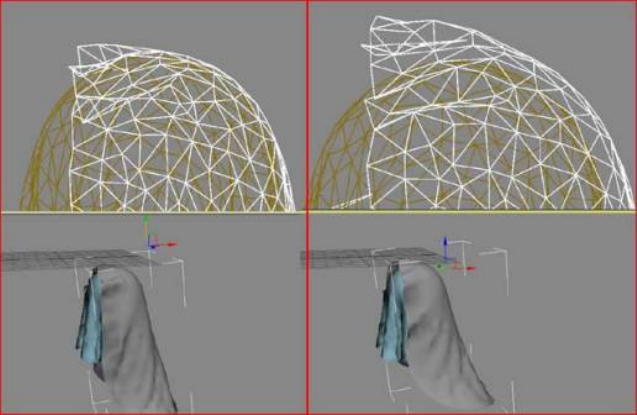
not to use too large or small values in this field. Very large values will interfere
with the natural behavior of the cloth. Very small values will cause the
simulator to take too long to calculate. This distance is measured in cm
(centimeters) and should be smaller than the size of the triangles that make
up the cloth object. A setting of 0.0 will let Cloth automatically assign a
reasonable value for thickness.
Left: The top piece of cloth with a Thickness of 0
Right: Thickness of 9
Repulsion The amount of force used to repel other cloth objects. This value
is irrelevant if cloth-to-cloth collisions are disabled. The simulator will apply
a repulsion force scaled by this value to keep the cloth from coming in contact
with other cloth objects. Increase this value if there are a lot of collisions
between different parts of cloth, or if the cloth is tending to interpenetrate.
Damping The larger this value, is the more sluggishly the fabric will react.
With a lower value, the fabric will behave with more spring. Cloth with more
damping will come to rest sooner then cloth with less damping. High damping
results in cloth that behaves as though it is moving through oil. Excessive
damping may also cause simulation instabilities. A good value is 0.01 (note:
the default is 0.1, but in practice, it seems that this value is too high).
Air Res. Resistance to Air. This value will determine how much the air will
effect the cloth. A higher amount of air resistance would be useful for a tightly
woven fabric, while a lower amount would be suitable for a loose-knit garment.
1214 | Chapter 9 Modifiers
Dyn. Fric. Dynamic friction between the cloth and solid objects. A larger
value will add more friction and cause the fabric to slide less across an object.
A lower value will allow the fabric to slip off an object very easily, similarly
to how silk would react.
Static Fric. Static friction between the cloth and solid objects. When the
cloth is in stationary position, this value will control its ability stay where it
is, or slip away.
Self Fric. Friction between the cloth and itself. This is similar to dynamic
and static friction, but applies to cloth-to-cloth or self-collisions. A larger value
will cause more friction between the cloth and itself.
U Scale Controls how much to shrink or expand the cloth along the U
direction (as defined by Garment Maker. For non-Garment Maker meshes,
this applies a uniform scaling to the cloth along both axes, and the V Scale
parameter is ignored). A value of less than 1 will shrink the fabric at simulation
time, while a value of more than 1 will stretch it.
V Scale Controls how much to shrink or expand the cloth along the V
direction (as defined by Garment Maker). A value of less than 1 will shrink
the fabric at simulation time, while a value of more than 1 will stretch it.
Seam Force Not presently used and only kept for backward compatibility
with older versions of the former product called Stitch. This was a global seam
strength, but seam strength is now defined on a seam-by-seam basis at the
Seams sub-object level.
Plasticity The tendency of the cloth to keep its current deformation (that is,
the bend angles).
This is different from Keep Shape on page 1226 , which determines the extent
to which the cloth tends to keep its original deformation (or the one defined
by the Target State). If you set Plasticity to 100.0, the cloth will not attempt
to change the angles between triangles. If you want stiffer cloth, but you don't
want the cloth to "balloon" up, increase the Plasticity value.
Depth Collision depth. If a portion of cloth reaches this depth inside a
collision object, then the simulation will no longer try to push the cloth out
of the mesh. This value is measured in 3ds Max units.
Offset The amount of distance kept between the cloth and the collision
object. A very low value can cause the collision mesh to protrude out from
under the cloth. A very high value will cause the fabric to look as if it is floating
on top of the collision object.
Cloth and Garment Maker Modifiers | 1215
Use Cloth Depth/Offset Uses the Depth and Offset values set for the panel
(see preceding). When on, the cloth object ignores the collision object Depth
and Offset values.
Cling The extent to which the cloth object adheres to a collision object.
Range=0.0 to 99999.0. Default=0.0.
You can use this parameter to simulate effects such as wet cloth. A setting of
1.0 should be just enough to hold the default material onto a surface against
its own weight.
Based on Lists the preset that the panel properties are based on. When you
modify parameters and save a preset, Cloth uses the name of the last preset
you loaded as the “Based on” name.
Anisotropic When on, you can set different U and V values for the Bend,
B-Curve, and Stretch parameters. The U and V directions are defined by
Garment Maker on page 1228 and do not apply to non-Garment Maker meshes,
for which setting different U/V values might result in unexpected behavior.
Use Edge Springs This is an alternative method for calculating stretch. When
this option is on, stretch force is based on springs along triangle edges.
(Whereas normally the stretch and shear forces are calculated in a more
sophisticated manner to more accurately reflect the underlying physics).
Use Solid Friction Uses the friction of the collision object to determine
friction. Values for collision can be assigned either to the cloth or the collision
objects. This enables you to set different friction values for each collision
object
Keep Shape group
Keep Shape When on, preserves the shape of the mesh based on the Bend
% and Stretch % settings (see following). In Lanormal operation, when Cloth
creates a simulation, it tries to "flatten out" the cloth.
Bend % Modulates the target bend angles to a value between 0.0 and the
angles defined by the target state on page 1190 . A negative value inverts the
angles. Range=-100.0 to 100.0. Default=100.0.
Stretch % Modulates the target stretch angles to a value between 0.0 and
the angles defined by the target state on page 1190 . A negative value inverts
the angles. Range=-100.0 to 100.0. Default=100.0.
Layer group
Layer Sets the layer for the selected panel. See “Behavior Settings,” above.
1216 | Chapter 9 Modifiers
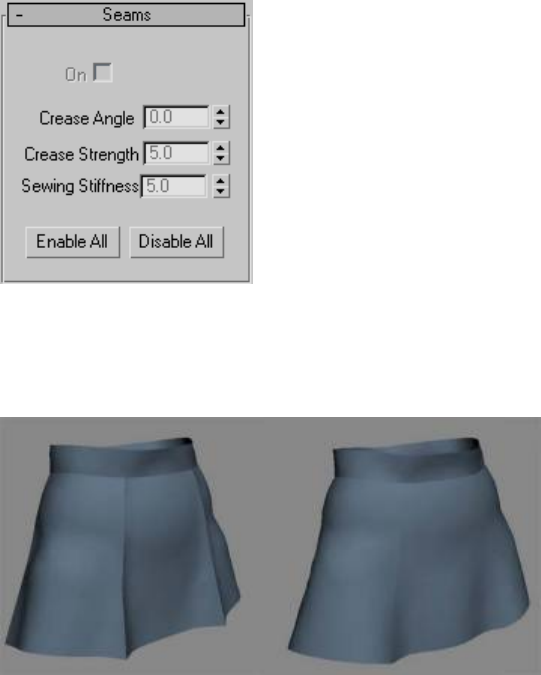
Seams rollout
The Seams sub-object rollout is used to define seam properties.
On Turn the seam on or off to make it active or inactive.
Crease angle Creates a crease at your seam. The angle value will determine
the angle of the crease that will be between the two panels. (Can be positive
or negative depending on which way you want to crease)
Left: High crease angle
Right: Low crease angle
Crease Strength Increase or decrease the strength of your seam. This value
will effect how much the seam will resist bending in relation to the rest of the
cloth object. A value of 2.0 means that the cloth will have twice the resistance
to bending that it would otherwise have (as defined by the object/panel/vertex
group properties).
Cloth and Garment Maker Modifiers | 1217
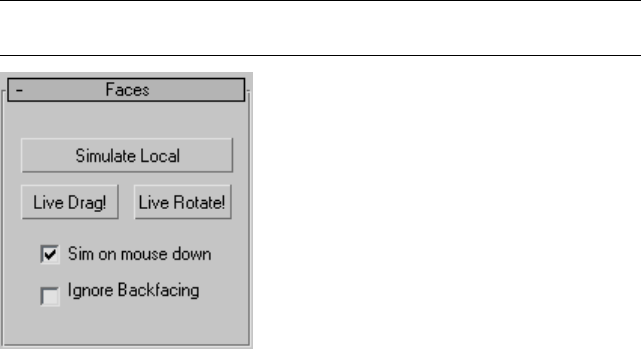
Sewing Stiffness The amount of force with which the panels will be pulled
together at simulation time. A larger value will pull the panels together harder
and faster.
Enable All Sets all seams on selected garment to be active.
Disable All Sets all seams on selected garment to be off. This button
deactivates the On check box for all seams.
Faces rollout
The Faces sub-object rollout enables interactive dragging of cloth objects while
they are simulated locally. This sub-object level is useful for positioning cloth
within your scenes in a more interactive way.
NOTE If you position your cloth incorrectly, you can restore the original position
by returning to the Object level and clicking the Reset State button.
Simulate Local Starts local simulation of the cloth. In order for the real-time
interactive feedback with the cloth to occur, this button must be on.
Live Drag! When active you can drag selected faces as the local simulation
is taking place.
Live Rotate! When active, you can rotate selected faces as the local simulation
is taking place.
Sim on mouse down Runs the local simulation only when the left mouse
button is clicked. This mode is usually preferred since you can start and stop
the local simulation simply by releasing the mouse button. As a result, it makes
it far easier to position and rotate the faces of your cloth within your scene.
1218 | Chapter 9 Modifiers
Ignore Backfacing When on, you can select only faces facing you. When off
(the default), you can select any faces under the mouse cursor, regardless of
visibility or facing.
Object Properties Dialog (Cloth)
Select an object. > Modify panel > Modifier List > Object-Space Modifiers >
Cloth > Object rollout > Object Properties button
Use the Object Properties dialog to specify which objects are included in a
Cloth on page 1178 simulation, whether they are cloth or collision objects, and
define parameters associated with them.
Cloth and Garment Maker Modifiers | 1219
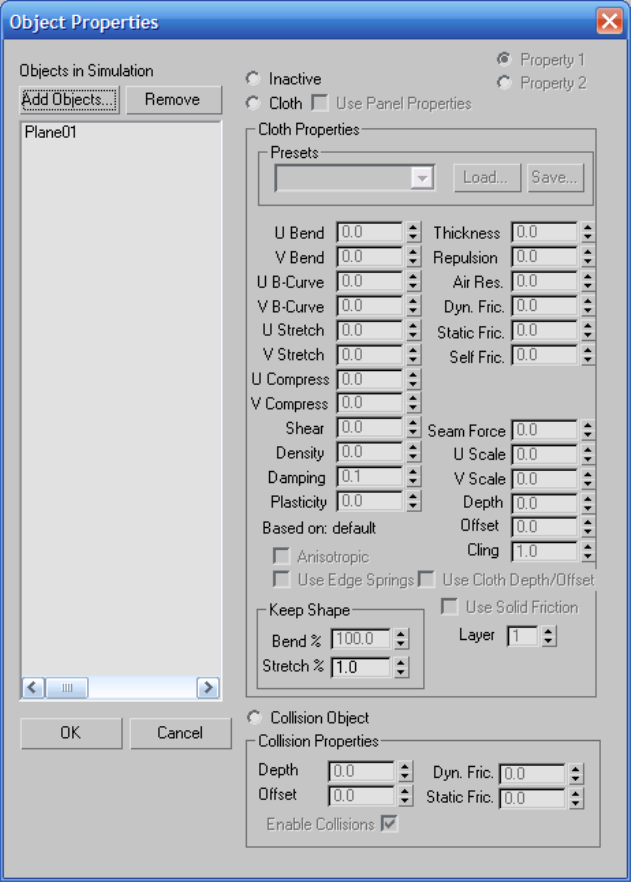
Interface
Objects in Simulation Lists objects currently included in the simulation. To
change an object's properties, first highlight its name in the list. You can
1220 | Chapter 9 Modifiers
highlight multiple object names using standard methods: Ctrl+click, Shift+click,
and dragging.
Add Objects Opens a dialog that lets you select objects from your scene to
be added to the Cloth simulation. After adding an object with this button, it
appears in the Objects In Simulation list, and an instance of the Cloth modifier
is applied to the object.
Remove Removes objects highlighted in the Objects In Simulation list from
the simulation. You cannot remove objects currently selected in 3ds Max.
Inactive Makes an object inactive in the simulation. The object can still be
in the simulation, but it will not react to anything. This is good for testing
how different objects react and isolating dynamic effects.
Property 1/Property 2 These two radio buttons let you assign two different
sets of cloth properties to objects highlighted in the Objects In Simulation
list. You can then use the Property Assignment group on page 1193 settings to
interpolate or animate between the sets. The Use Cloth Depth/Offset, Use
Edge Springs, Use Solid Friction, and Keep Shape options can be set only for
Property 1 because Property 2 uses the same settings.
Cloth Sets the object or objects highlighted in the Objects In Simulation list
to cloth objects and allows you to define parameters for them in the Cloth
Properties section of the dialog.
Use Panel Properties When on, tells Cloth to use the Cloth Properties from
the Panel sub-object level of the Cloth modifier. This allows you to define
different cloth properties on a panel-by-panel basis.
Cloth Properties group
Presets Sets the Cloth Properties parameters to the preset chosen from the
drop-down list. Any presets that are built into the system or that have been
previously saved and loaded will show up here.
Load Loads presets from your hard drive. Click this button and then navigate
to the directory with your presets to load them into Cloth Properties.
Save Saves Cloth Properties parameters to a file to be loaded at a later time.
By default, all Cloth preset files are saved to your \scenes\cloth folder.
U Bend/V Bend Resistance to bending. The higher this value is set, the less
the fabric will be able to bend. A cotton fabric might bend more easily than
leather, so a value of 15.0 for both U and V Bend might be good for cotton,
while 50.0 would work well for leather.
Cloth and Garment Maker Modifiers | 1221
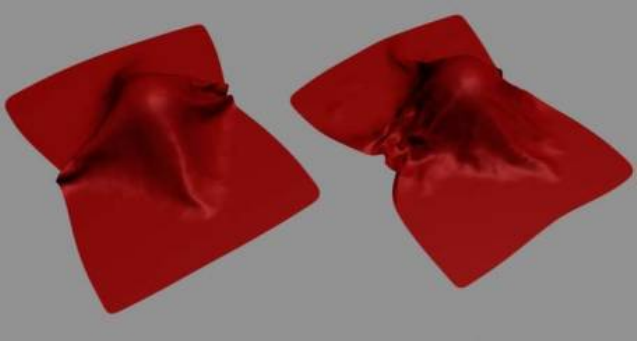
By default, the U Bend and V Bend parameters are locked together so that
changing one sets the other to the same value. You can set different values
for the two only when Anisotropic on page 1226 is off. It is recommended to
do this only for Garment Maker on page 1228 objects.
Left: U and V Bend=50, simulating a burlap material
Right: U and V Bend=2.5, simulating silk or other light fabric
Thickness Defines the virtual thickness of a fabric for the purpose of detecting
cloth-to-cloth collisions. This value is irrelevant if cloth-to-cloth collisions are
disabled. Larger values keep the cloth separated by greater distances. Be careful
not to use too large or small values in this field. Very large values will interfere
with the natural behavior of the cloth. Very small values will cause the
simulator to take too long to calculate. This distance is measured in cm
(centimeters) and should be smaller than the size of the triangles that make
up the cloth object. A setting of 0.0 will let Cloth automatically assign a
reasonable value for thickness.
1222 | Chapter 9 Modifiers
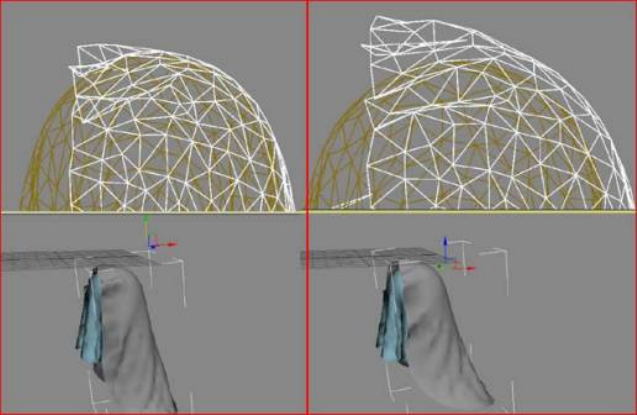
Left: The top piece of cloth with a Thickness of 0
Right: Thickness of 9
Repulsion The amount of force used to repel other cloth objects. This value
is irrelevant if cloth-to-cloth collisions are disabled. The simulator will apply
a repulsion force scaled by this value to keep the cloth from coming in contact
with other cloth objects. Increase this value if there are a lot of collisions
between different parts of cloth, or if the cloth is tending to interpenetrate.
U B-Curve/V B-Curve Resistance to bending as the fabric folds. The default
value of 0 sets the bend resistance to be constant. A setting of 1 makes the
fabric very resistant to bending as the angle between triangles approaches 180
degrees. You never want two adjacent triangles to pass through each other,
so you can increase this value to prevent this from happening.
By default, the U B-Curve and V B-Curve parameters are locked together so
that changing one sets the other to the same value. You can set different values
for the two only when Anisotropic on page 1226 is off. It is recommended to
do this only for Garment Maker on page 1228 objects.
Air Res. Resistance to air. This value will determine how much the air will
effect the cloth. A higher amount of air resistance would be useful for a tightly
woven fabric, while a lower amount would be suitable for a loose-knit garment.
Dyn. Fric. Dynamic friction between the cloth and solid objects. A larger
value will add more friction and cause the fabric to slide less across an object.
Cloth and Garment Maker Modifiers | 1223

A lower value will allow the fabric to slip off an object easily, similarly to how
silk would react.
U Stretch/V Stretch Resistance to stretching. The default value of 50.0 is a
reasonable value for most types of cloth. A Larger value will be stiffer, while
a smaller one will be stretchy like rubber.
By default, the U Stretch and V Stretch parameters are locked together so that
changing one sets the other to the same value. You can set different values
for the two only when Anisotropic on page 1226 is off. It is recommended to
do this only for Garment Maker on page 1228 objects.
U Compress / V Compress Resistance to compression. Although
these values default to 50.0, like their counterpart Stretch values, assigning
values lower than the Stretch values can give good results, because when cloth
is compressed along the length of its fibers, it tends to buckle rather than
shrink.
By default, the U Compress and V Compress parameters are locked together
so that changing one sets the other to the same value. You can set different
values for the two only when Anisotropic on page 1210 is off. It is recommended
to do this only for Garment Maker on page 1228 objects.
Static Fric. Static friction between the cloth and solid objects. When the
cloth is in stationary position, this value will control its ability stay where it
is, or slip away.
Self Fric. Friction between the cloth and itself. This is similar to dynamic
and static friction, but applies to cloth-to-cloth or self-collisions. A larger value
will cause more friction between the cloth and itself.
Shear Resistance to shearing. Higher values result in stiffer cloth fabrics.
Shear defines how much the individual triangles can deform. If you were to
lay the edges of the triangle out in a strait line this value would represent how
long this line can stretch out to. With a high value this length will only be
the sum of the length of all of the sides at rest. A low value will allow this
length to be greater then that off all of its sides at rest. This length of stretched
sides is not on a one to one basis. One side of the polygon may stretch more
then another as long as the Seam Force Not presently used and only kept
for backward compatibility with older versions of the former product, called
Stitch. This was a global seam strength, but seam strength is now defined on
a seam-by-seam basis at the Seams sub-object level.total shear value is not
exceeded.
Density The weight of the cloth per unit area (in gm/cm2). Higher values
mean heavier cloth like denim. Use smaller values for lighter cloth like silk.
1224 | Chapter 9 Modifiers
Damping The larger this value, is the more sluggishly the fabric will react.
With a lower value, the fabric will behave with more spring. Cloth with more
damping will come to rest sooner then cloth with less damping. High damping
results in cloth that behaves as though it is moving through oil. Excessive
damping may also cause simulation instabilities. A good value is 0.01 (note:
the default is 0.1, but in practice, it seems that this value is too high).
U Scale Controls how much to shrink or expand the cloth along the U
direction (as defined by Garment Maker). For non-Garment Maker meshes,
this applies a uniform scaling to the cloth along both axes, and the V Scale
parameter is ignored). A value of less than 1 will shrink the fabric at simulation
time, while a value of more than 1 will stretch it.
V Scale Controls how much to shrink or expand the cloth along the V
direction (as defined by Garment Maker). A value of less than 1.0 will shrink
the fabric at simulation time, while a value of more than 1.0 will stretch it.
Plasticity The tendency of the cloth to keep its current deformation (that is,
the bend angles).
This is different from Keep Shape on page 1226 , which determines the extent
to which the cloth tends to keep its original deformation (or the one defined
by the Target State). If you set Plasticity to 100.0, the cloth will not attempt
to change the angles between triangles. If you want stiffer cloth, but you don't
want the cloth to "balloon" up, increase the Plasticity value.
Depth Collision depth for the cloth object. If a portion of cloth reaches this
depth inside a collision object, then the simulation will no longer try to push
the cloth out of the mesh. This value is measured in 3ds Max units.
To specify a Depth value specific to the cloth object, use this setting and be
sure to turn on Use Cloth Depth/Offset on page 1226 .
Offset The distance maintained between the cloth object and the collision
object. A very low value can cause the collision mesh to protrude from under
the cloth. A very high value causes the fabric to appear to be floating above
the collision object. This value is measured in 3ds Max units.
To specify an Offset value specific to the cloth object, use this setting and be
sure to turn on Use Cloth Depth/Offset on page 1226 .
Cling The extent to which the cloth object adheres to a collision object.
Range=0.0 to 99999.0. Default=0.0.
Cloth and Garment Maker Modifiers | 1225
You can use this parameter to simulate effects such as wet cloth. A setting of
1.0 should be just enough to hold the default material onto a surface against
its own weight.
Use Cloth Depth/Offset Uses the Depth on page 1225 and Offset on page
1225 values set in Cloth Properties. When on, the cloth object ignores the
collision object Depth and Offset values.
Based on Displays the preset that the Cloth Properties are based on. When
you modify some parameters and save a preset, it will use the name of the last
preset you loaded as the Based on name.
Anisotropic When on, you can set different U and V values for the Bend,
B-Curve, and Stretch parameters. The U and V directions are defined by
Garment Maker on page 1228 and do not apply to non-Garment Maker meshes,
for which setting different U/V values might result in unexpected behavior.
Use Edge Springs Enables an alternative method for calculating stretch.
When on, stretch force is based on springs along triangle edges. When off,
the stretch and shear forces are calculated in a more sophisticated manner to
more accurately reflect the underlying physics.
Use Solid Friction Uses the friction of the collision object to determine
friction. Values for collision can be assigned either to the cloth or the collision
objects. This enables you to set different friction values for each collision
object.
Keep Shape These settings preserves the shape of the mesh based on the
values of Bend % and Stretch % (see following). In normal operation, when
Cloth creates a simulation, it tries to "flatten out" the cloth. To enable these
settings, turn on Use Target State on page 1190 .
Bend % Modulates the target bend angles to a value between 0.0 and the
angles defined by the target state on page 1190 . A negative value inverts the
angles. Range=-100.0 to 100.0. Default=100.0.
Stretch % Modulates the target stretch angles to a value between 0.0 and
the angles defined by the target state on page 1190 . Range=0.0 to 100.0.
Default=100.0.
Layer Indicates the correct "order" of cloth pieces that might come in contact
with each other. Range=-100 to 100. Default=0.
If your garments and/or panels are all correctly orientated to begin with, then
cloth-to-cloth collision detection should keep items from interpenetrating.
However, the initial state of a garment/panel might have some interpenetration
that cannot be resolved. For example, suppose you make a jacket with Garment
Maker where the front right panel is supposed to sit on top of the front left
1226 | Chapter 9 Modifiers
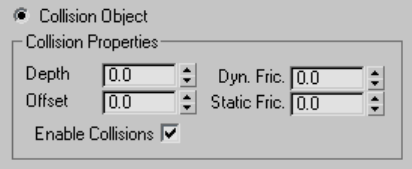
panel. When you sew together the garment (generally with self-collision off),
the front panels will interpenetrate, so to make sure that the right panel sits
outside the left panel, you might have to use constraints or Live Drag. Using
the Layers option on the panels can help here.
Here is the logic of layers: When two pieces of cloth (A and B) are in
collision-detection range, their layers (layerA and layerB) are compared and
the following rules are applied:
■If either layerA or LayerB is 0, then Cloth uses the regular cloth-to-cloth
collision method.
■If layerA=layerB, then Cloth uses the regular cloth-to-cloth collision
method.
■If abs(layerA) > abs(layerB) then piece A is pushed to the appropriate side
of piece B. Which side? If layerB > 0, then to the side indicated by the face
normals. If layerB<0 then to the opposite side.
The sign of the Layer value indicates what the "outside" of that piece of cloth
is. A positive sign means "The side that the normals face is the outside".
Collision Properties group
Collision Object Sets the object or objects highlighted in the left-hand column
to be collision objects. Cloth objects bounce off or wrap around collision
objects.
Depth Collision depth for the collision object. If a portion of cloth reaches
this depth inside a collision object, then the simulation will no longer try to
push the cloth out of the mesh. This value is measured in 3ds Max units.
Offset The distance maintained between the cloth object and the collision
object. A very low value can cause the collision mesh to protrude out from
under the cloth. A very high value will look like the fabric is floating on top
of the collision object. This value is measured in 3ds Max units.
Cloth and Garment Maker Modifiers | 1227
Dyn. Fric. Dynamic friction between the cloth and this particular solid object.
A larger value will add more friction and cause the fabric to slide across an
object less. A lower value will allow the fabric to slip of an object very easily,
similarly to how silk would react. This value is only used for interaction with
cloth objects that have Use Solid Friction enabled, otherwise the friction value
is taken from the cloth's own properties.
Static Fric. Static friction between the cloth and solid objects. When the
cloth is in stationary position, this value will control its ability stay where it
is, or slip away. This value is only used for interaction with cloth objects that
have Use Solid Friction enabled otherwise the friction value is taken from the
cloths own properties.
Enable Collisions Enables or disables collisions for this object while still
allowing it to be in the simulation. This means the object can still be used for
making surface constraints.
Garment Maker Modifier
Select a shape object (spline or NURBS curve). > Modify panel > Modifier List
> Object-Space Modifiers > Garment Maker
Garment Maker is a modifier that is designed to put together 2D patterns that
you can then use with Cloth on page 1178 . With Garment Maker you can take
a simple, flat, spline-based pattern and convert it to a mesh, arrange its panels,
and create seams to sew the panels together. You can also specify internal
seam lines on page 1236 for creases and cuts.
See also:
■Troubleshooting and Error Codes in Garment Maker on page 1258
■Cloth and Garment Maker Modifiers on page 1162
■Cloth Overview on page 1163
■Cloth Modifier on page 1178
Basic Concepts
Splines
When you start working with Garment Maker, you begin either by importing
or drawing traditional 2D splines in the 3ds Max Top viewport. To use a spline
1228 | Chapter 9 Modifiers
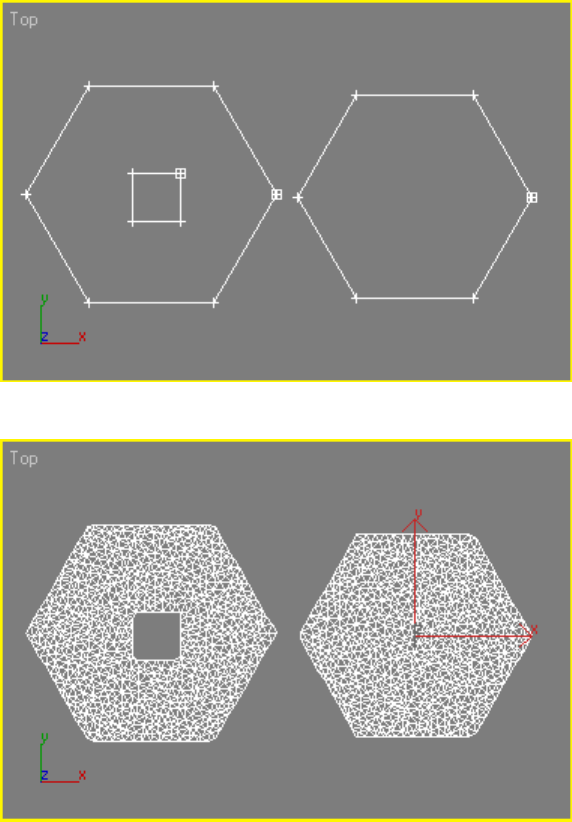
with Garment Maker and eventually Cloth, it must be a closed shape. This
does not mean that you cannot have splines inside of splines, but if you have
multiple spline shapes inside of one another, the inner splines are treated as
"holes" in the fabric, as shown below.
Two closed splines - one with a nested spline inside
Resulting geometry after applying Garment Maker
Cloth and Garment Maker Modifiers | 1229
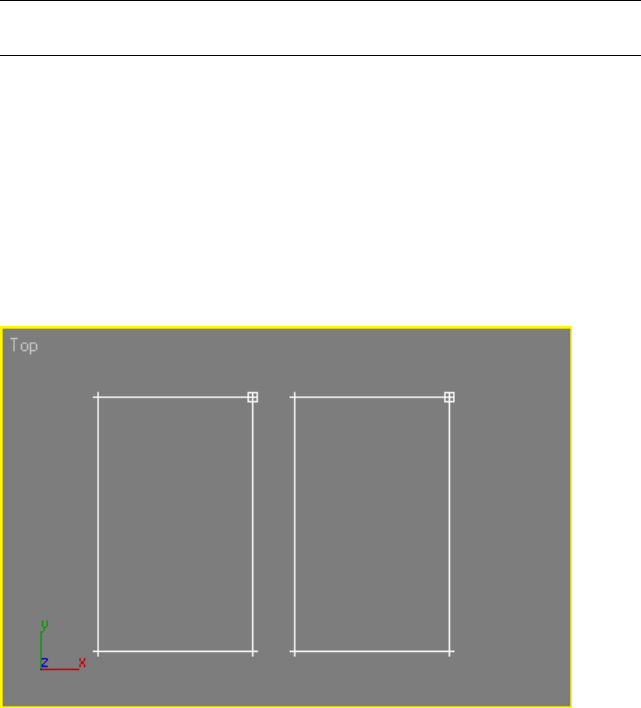
TIP For best results, when applying Garment Maker to multiple splines, first
combine the splines into a single object.
Also, to keep your patterns precise, no rounding of boundary edges and corners,
you must break the splines at the corner vertices. This is also important because
it directly impacts the segments of the splines that are to be used to create
seams between the individual panels. To understand this better, take a look
at the following example.
In the image below are two rectangular splines to which a user might want
to apply Garment Maker. After applying Garment Maker, the idea is to then
create a seam between the two panels along the inner edge. First, it should be
noted that both splines are closed shapes and have been attached so they are
part of the same editable spline object.
When Garment Maker is assigned, look what happens:
1230 | Chapter 9 Modifiers
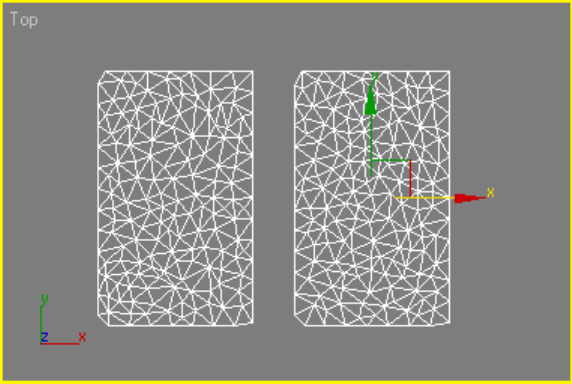
Garment Maker seems to have "chopped" corners of the rectangular splines
off, altering the pattern. Beyond that, if the user tried to select the edges of
the panels that make up the seam, they will not be able to. This is because
Garment Maker currently has only a single spline to work with for each panel.
To keep the pattern clean, do the following:
1Access the Vertex sub-object level of the editable spline.
2Select the vertices where seams are to be created.
3Click Break to create unique segments that Garment Maker can use to
create a seam.
Shown below are the results when all of the vertices are selected and then
broken.
Cloth and Garment Maker Modifiers | 1231
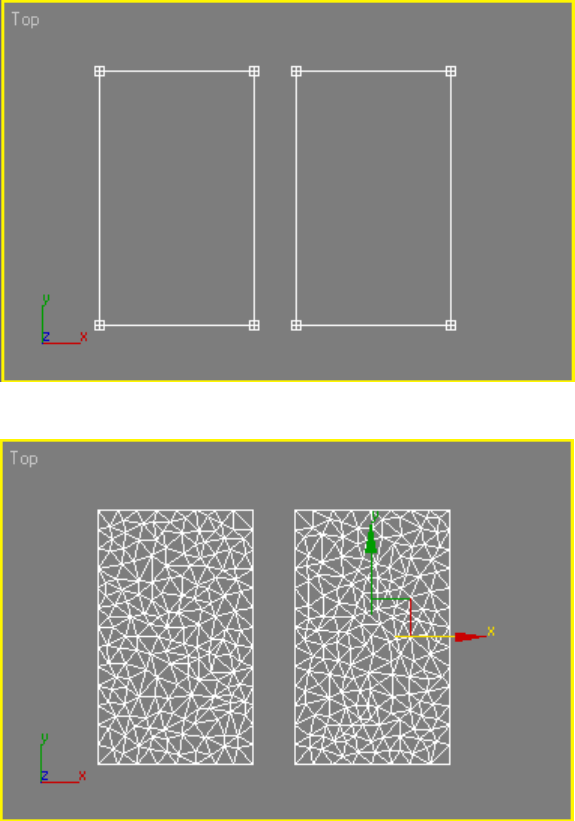
All vertices in both panels selected and then "broken"
Garment Maker applied to "broken" splines
The corners are now preserved. When the user goes to select the edges between
the panels to act as seams, they will be selected independently of the other
panel edges and highlight in red. This is what you want in order to create
seams.
1232 | Chapter 9 Modifiers
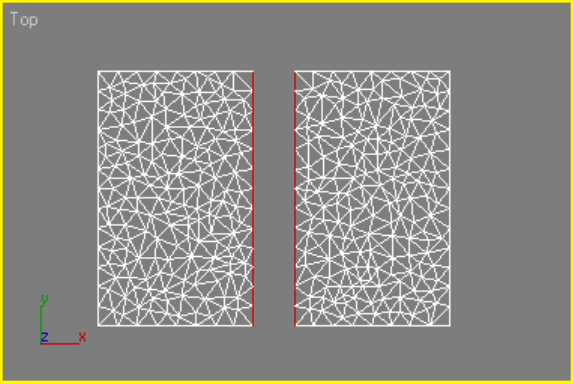
Seam edges selected at the Seam sub-object level in red
Garment Panels
Garment Maker's Panels sub-object level lets you arrange the panels of the
pattern around the character. You can then create seams where the panels
should connect and be "sewn" together. This lets you create the seams you
need while seeing how the clothing will look around your character. Creating
seams like this is in many cases far superior to making them in a flat layout
because it allows you to visualize what is being done.
Cloth and Garment Maker Modifiers | 1233
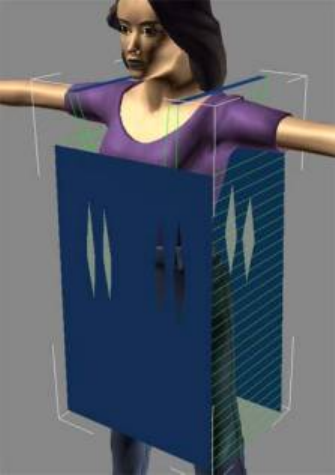
Arranged panels with seams defined
Pattern Creation
To make patterns you can use the basic 2D spline tools in 3ds Max. Cloth
comes with several patterns, but after you learn to use them, you will most
likely want to start making your own. Patterns can take advantage of many
features that real sewing patterns have, such as darts and multi-segment seams.
To learn about other pattern making software, see Pattern-Making Software
on page 1178 .
Tricky Assemblies
As you begin to move beyond the basic patterns for your garments, there are
a number of rules that you should follow in order to work effectively with
Cloth:
■Always create your pattern splines in the Top viewport. Garment Maker
assumes that the pattern is laid out this way.
■When seaming garments with MultiSegment edges, you must take care of
the order in which the seams are made.
1234 | Chapter 9 Modifiers

NOTE A MultiSegment comprises two or more individual segments acting as
a single segment; you create it with Garment Maker.
When creating a seam you cannot use:
■A MultiSegment that has multiple gaps in it, unless all but one of those
gaps are bridged by another seam.
■A segment or MultiSegment that forms a closed loop (that is, a path directly,
or via seams, completely encloses the MultiSegment).
Both these issues arise in the common sleeve assembly shown below. The
sleeve needs to be sewn to the armhole. When assembled, both the sleeve and
the armhole form closed loops. The sleeve forms a loop via the seam along
its underside. The armhole is closed by two seams: one across the shoulder
and one down the side.
Now, since you cannot seam closed loops together, it therefore follows that
both the armhole and sleeve must be left open when creating the seam
connecting them. So the order is as follows:
1Because the sleeve is one segment and the armhole is two segments, you
must make a MultiSegment out of those two segments first.
2When dealing with MultiSegment seams, the order of creation is
important. If you attempt to create seams in the wrong order, you might
get a “Seamline topology is wrong” error, and the seams will not be
created. When dealing with MultiSegment seams, create the minimum
number of seams necessary to make the MultiSegment seam match the
topology of the other piece to that you are going to connect.
In this case, you have an arm seam that is open at the bottom, and a
MultiSegment that is open at both the top and the bottom. If you closed
the side of the garment, you'd end up with the situation illustrated in
the center image below, where the seam is twisted (it cannot be
“untwisted” by reversing the seam). By closing the top of the armhole
MultiSegment with a seam at the shoulder, you'll create proper topology
to make the MultiSegment seam.
3Next, you can seam up the sleeve to the armhole. See the leftmost image
below.
4Finally, you can add the seam down the side of the garment and across
the underside of the sleeve (the order is irrelevant here).
Cloth and Garment Maker Modifiers | 1235
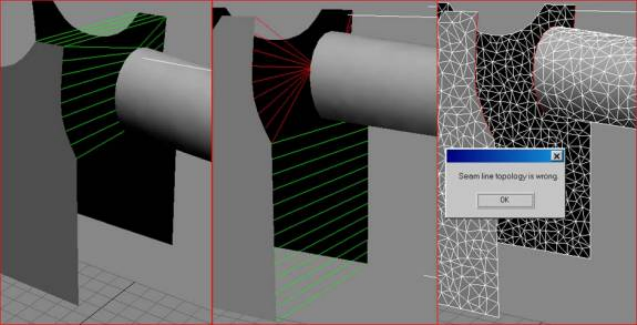
Left: Seam created for shoulder first and then for the MultiSegment, producing the
desired result.
Middle: Seam created at the bottom of the body MultiSegment first, resulting in an
irreversible MultiSegment seam from the arm to the body.
Right: No seams made on the body to connect its MultiSegment, resulting in a seam
topology error.
Internal Seam Lines
When drawing panels, you can use extra open splines to define seam lines
within the panels, also known as internal seam lines. Triangulation always
occurs along these internal seam lines, so you can use them to help define
the structure of the cloth panel, and as crease lines on page 1257 . Also, you
can specify that an internal seam line should be cut on page 1252 , so that the
cloth separates along the line during the simulation.
To create an internal seam line, simply specify a Material ID of 2 for the
internal spline, which should not be closed. Also, for best results, keep its
endpoints away from other splines in the shape. And, as with outside seam
lines, an internal spline should not cross over itself or other splines.
1236 | Chapter 9 Modifiers
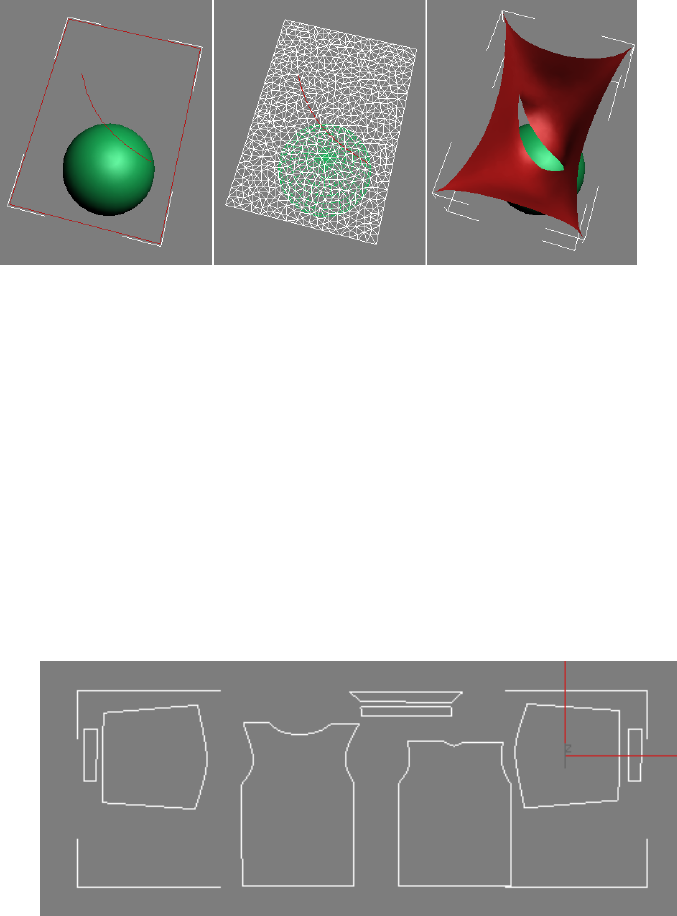
Left: Open spline, set to Material ID 2, specifies internal seam line.
Center: At Garment Maker > Curves or Seams sub-object level, seam line is selected
and Cut is turned on.
Right: Cloth separates along cut line during simulation.
Procedures
To place garment panels automatically:
The Garment Maker modifier provides tools for positioning garment panels
on a humanoid character model. This automatic placement is approximate;
further adjustment is typically necessary.
1Load or create your character model.
2Create your panels as splines or NURBS curves parallel to the world XY
plane (that is, create them in the Top viewport).
Shirt panels, as seen in the Top viewport
Cloth and Garment Maker Modifiers | 1237
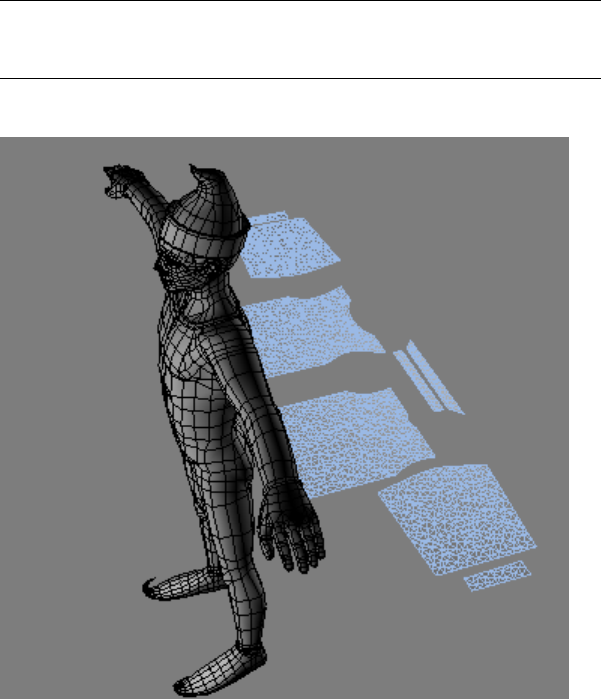
TIP When applying Garment Maker to multiple splines, for best results, first
combine the splines into a single object. You can still manipulate the separate
pieces within the Garment Maker modifier at the Panels sub-object level.
3Apply the Garment Maker modifier. Set parameters as necessary.
4On the Main Parameters rollout, click the None button, and then click
the character model.
The object's name appears on the button.
5Below this button, click the Mark Points On Figure button.
A character outline appears in the corner of each viewport. Superimposed
on the outline are seven asterisk-shaped points; the one at the center-top
of the chest is highlighted in red.
1238 | Chapter 9 Modifiers
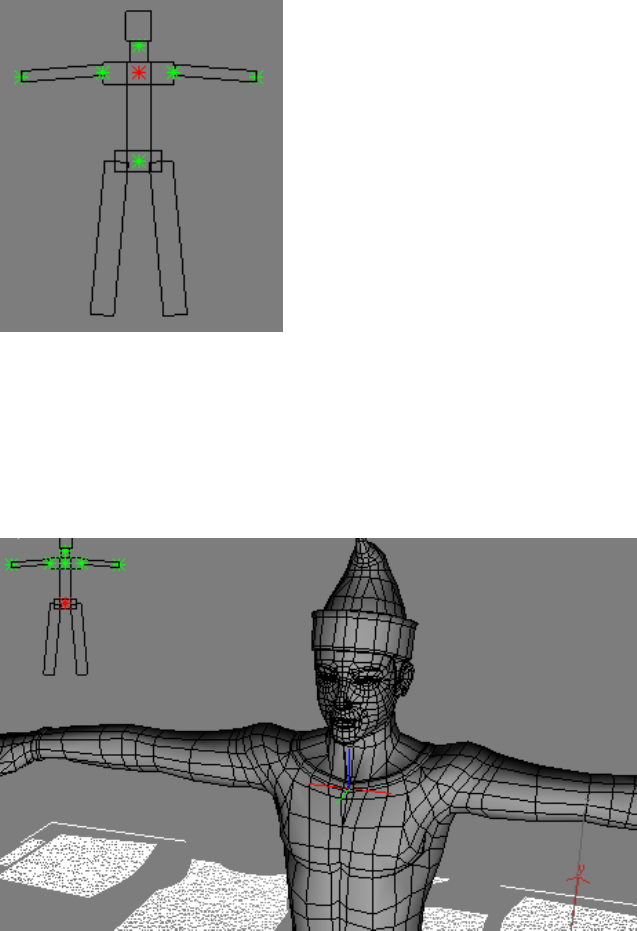
The character outline lets you mark points for positioning panels.
6Click the corresponding point on the front of your model.
As you move the mouse cursor over the surface of the model, a red circle
shows where the marker will be placed. When you click, an axis tripod
appears on the surface at that location, and the next point on the
character outline, at the center of the pelvic region, is highlighted in red.
The axis tripod appears on the object surface where you click.
Cloth and Garment Maker Modifiers | 1239
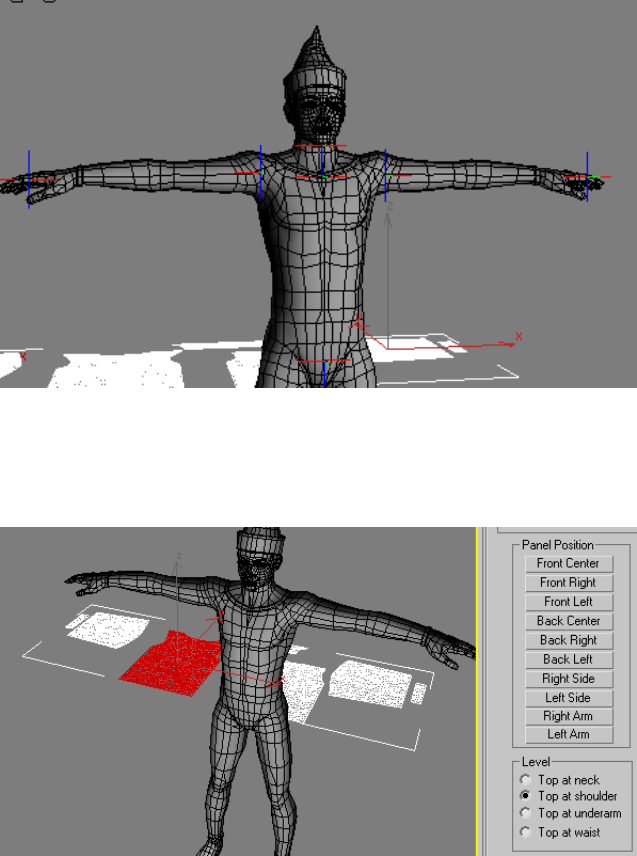
7Continue to click at each location on your model that corresponds to
the highlighted marker on the character outline until you've designated
all seven points.
All seven points are marked on the character model.
To finish, right-click in the viewport.
8Go to the Panels sub-object level and select a panel.
The front shirt panel is selected.
1240 | Chapter 9 Modifiers
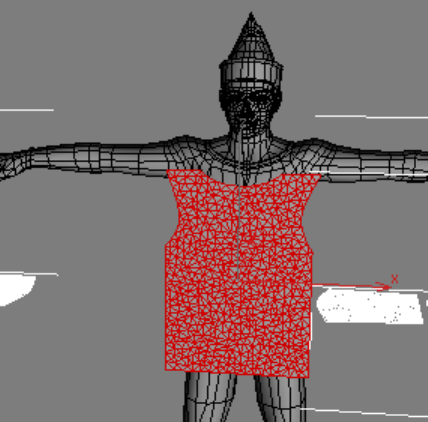
9At the bottom of the Panels rollout, choose a Level, and then in the Panel
Position group, click the button corresponding to the desired position
for the panel.
The panel moves to the designated position.
Panel Position=Front Center; Level=Top at shoulder
10 Adjust as necessary. For example, in the above illustration, Level should
probably be set to Top At Neck. To correct this, you would choose Top
At Neck, and then click Panel Position > Front Center again.
Cloth and Garment Maker Modifiers | 1241
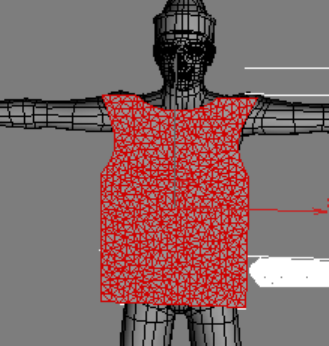
Panel Position=Front Center; Level=Top at neck
Of course, you can also move the panel manually; in fact, in most cases
it will probably be necessary to do so. Panel Position serves primarily as
a starting point for placing panels.
11 Continue selecting panels and placing them, adjusting as necessary.
1242 | Chapter 9 Modifiers
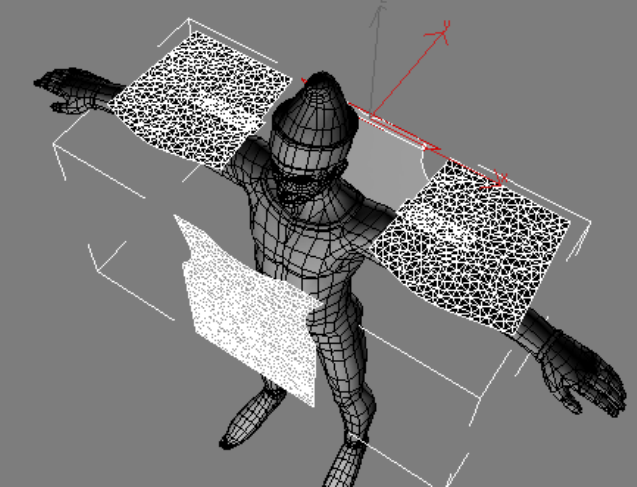
All panels placed with Panel Position. Note that sleeve panels need to be rotated
90 degrees, and cuff panels need to be rotated and moved to the wrists.
Interface
The Garment Maker interface varies depending on the current modifier stack
level: object (Main Parameters) on page 1243 or one of the four sub-object
levels:
■Curves on page 1249
■Panels on page 1252
■Seams on page 1255
Main Parameters rollout
The Main Parameters rollout is the first rollout you see on the Modify panel
once you apply the Garment Maker modifier. This rollout comprises mostly
controls to create and adjust the mesh.
The remaining rollouts are available at the sub-object levels.
Cloth and Garment Maker Modifiers | 1243
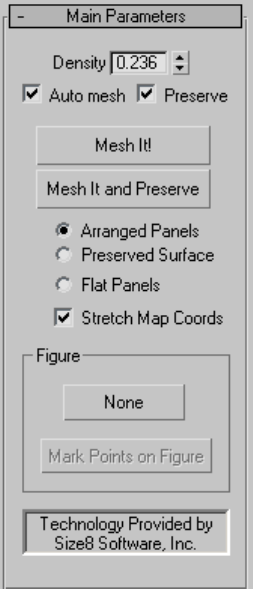
Density Adjusts the relative density of the mesh (in other words, the number
of triangles per unit area). Possible values range between 0.01 and 10.0. A
value of 10.0 creates a very dense mesh, while 0.01 creates a comparatively
low-resolution mesh.
For best results, use the lowest possible density to achieve the desired result.
This speeds up simulation time and overall performance.
1244 | Chapter 9 Modifiers
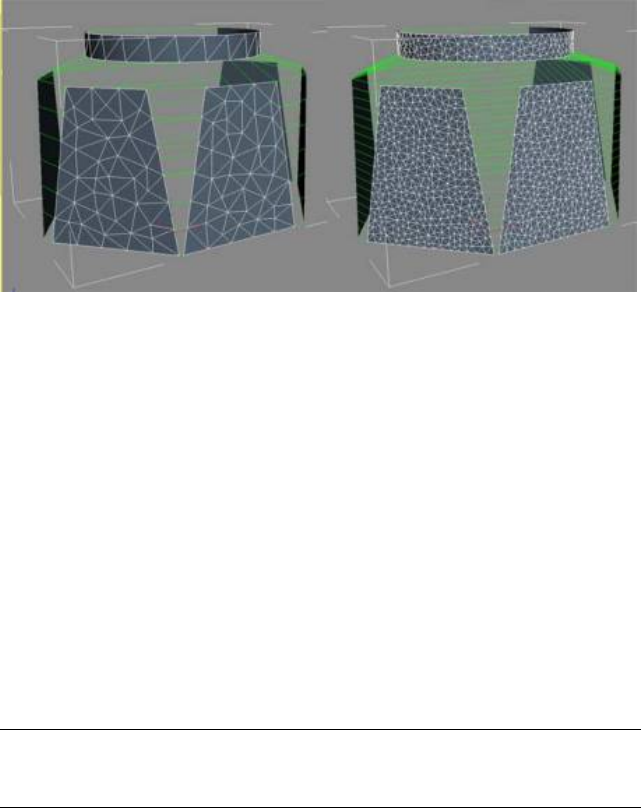
Left: Density=0.5
Right: Density=1.5
Auto mesh When on, Garment Maker updates the mesh automatically if
you change the density or add/remove seams.
This setting is active at all sub-object levels, so it's recommended you leave it
on to see changes as you make them. The only time you might want to turn
off Auto Mesh is while creating the seams at the Curves sub-object level.
Re-meshing can take some time, so you might want to define a number of
seams before re-meshing.
Preserve When on along with Auto mesh, Garment Maker preserves the 3D
shape of the object. When off, if you change the Density value, the panels are
flat.
Mesh It! Applies a change in the Density value. If Auto mesh is off when
you change the Density value, you must click the Mesh It! button to apply
the change.
TIP Sometimes in an error condition Mesh It! will no longer respond. If this
happens, go to the spline level in the modifier stack, and then return to the
Garment Maker level.
Mesh It and Preserve Applies a Density change and also preserves the 3D
shape of the object. This lets you change the density of the cloth or the
Cloth and Garment Maker Modifiers | 1245
underlying spline shape after simulating without having to run the simulation
again.
The following setting, comprising three radio buttons, determines how the
cloth panels are passed up the modifier stack to the Cloth modifier:
■Arranged Panels With this option, the mesh passed up the stack will be
have the panels arranged/bent around the figure as they were placed by
the user in panels sub-object mode.
■Preserved Surface When both Auto mesh and Preserve are on, or when
you click Mesh It And Preserve, Garment Maker takes a snapshot of the
mesh at the top of the stack (where Cloth is applied). This snapshot is
passed up the stack when you choose Preserved Surface. This way, if you
change the Density value, the mesh will retain its deformation. Once a
snapshot has been taken, at the Panel sub-object level, the panels will have
the Use Preserved check box on. This means you can move the panels
around while maintaining their deformation. Also note that once a
snapshot has been taken, Garment Maker automatically chooses the
Preserved Surface option.
■Flat Panels Displays all the panels as flat surfaces. This mode defines the
texture coordinates of the garment vertices. With this output mode active,
you can adjust texture coordinates at the Panel sub-object level by moving
and rotating the panels.
Stretch Map Coords When on, Garment Maker uses the bounding box of
the original spline shape in defining the texture mapping coordinates. The
lower-left corner of the box is always assigned UV coordinates of (0,0). If
Stretch Map Coords is on, the upper-right corner has coordinates of (1,1). This
conforms to the 3ds Max convention for bitmap textures. If the box is off, the
upper-right corner has coords (1,a) (a>1) or (a,1) (a>1), which are chosen to
preserve the proportions of the box. This is appropriate for procedural textures.
1246 | Chapter 9 Modifiers
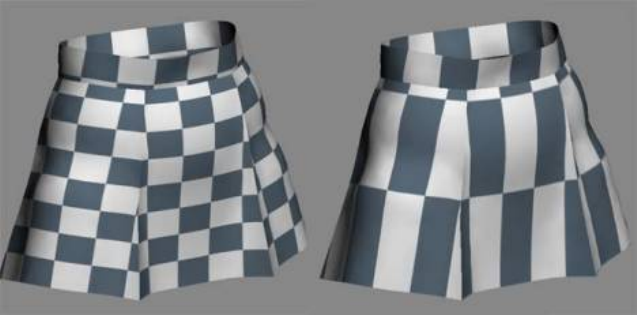
Left: Stretch Map Coords on
Right: Stretch Map Coords off
Figure group
Use these controls to specify locations for each panel on the figure to be
clothed
[button] Click this button, labeled “None” by default, and then click the
object, or figure, to which the clothing is to be applied. Typically this is a
character model. Thereafter, the name of the object appears on the button.
Mark Points on Figure After specifying a figure using the “None” button (see
preceding), use this control to specify locations on the figure for automatically
positioning panels in the garment.
When you click Mark Points On Figure, this character outline appears in the
corner of each viewport:
Cloth and Garment Maker Modifiers | 1247
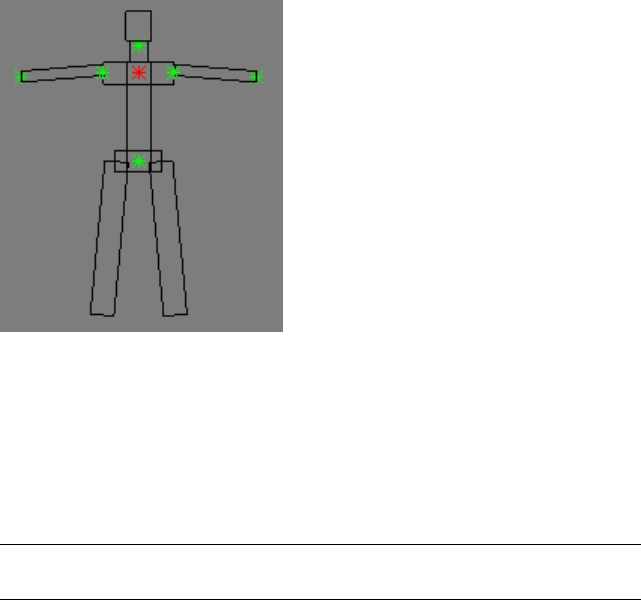
The character outline lets you mark points for positioning panels.
As each point highlights in red, click the corresponding location on your
figure. When you do so, an axis tripod appears on the object surface and the
next point on the outline highlights. During this process you can manipulate
the viewport as usual, zooming, panning, and rotating freely. You can continue
clicking points as long as you like; to stop, right-click in the viewport, or turn
the button off.
NOTE If you return to marking points later, the software starts again where you
left off earlier.
The points highlight in this order:
1Upper Chest
2Pelvis
3Neck
4Right shoulder
5Left shoulder
6Right hand
7Left hand
After setting the points, you can use the Panel Position on page 1254 and Level
on page 1254 controls at the Panels sub-object level to place the panels
automatically.
1248 | Chapter 9 Modifiers
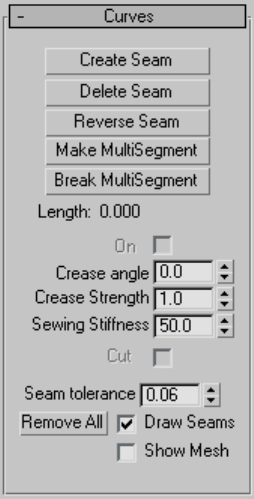
Curves rollout
Use the Curves sub-object level to stitch your pattern panels together. You
can also connect seams in the Seams sub-object mode with a more
three-dimensional representation of the panels. The Curves sub-object level
provides a flat layout to work in that can be useful for more complex patterns.
You can create and delete seams and adjust the way your pattern fits together.
Create Seam Creates a seam between two segments. Select two segments of
the panels you would like to sew together, and click Create Seam. This will
make a seam between these two panels that will be sewn together at simulation
time. Seams get a randomly-generated color to distinguish them from the
panels.
Cloth and Garment Maker Modifiers | 1249
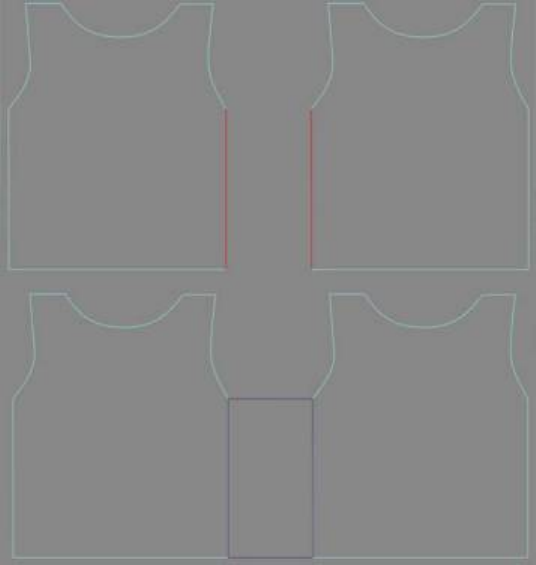
Top: Segments selected
Bottom: Seam made between two panels
Delete Seam Deletes selected seam. (Selected seam is colored red).
Reverse Seam Reverses or flips a twisted seam.
When creating seams, the first vertex on each segment is used to line up the
resulting seam panel. Sometimes you can end up with a twisted seam and will
need to use Reverse Seam to untwist it.
1250 | Chapter 9 Modifiers
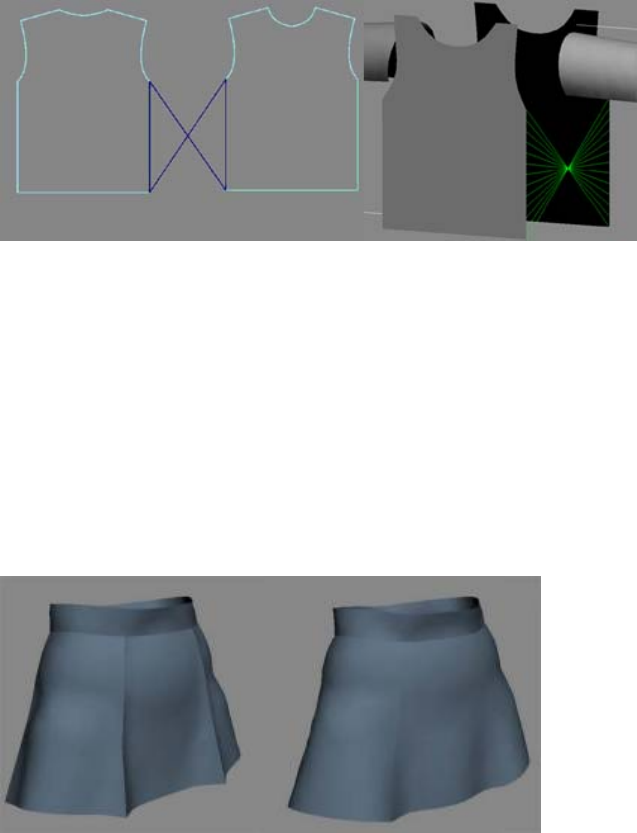
A twisted seam that needs to be reversed
Make MultiSegment A MultiSegment is a combination of two or more
segments that will be treated as one segment for the purpose of creating seams.
Select the segments you want to combine then click this button. Note that if
the segments are not contiguous, the gaps must be bridged by seams before
this MultiSegment can be used in a seam.
Break MultiSegment Break apart selected MultiSegments.
On Turns the selected seam on or off, making it active or inactive.
Crease angle Creates a crease at the selected seam. The angle value determines
the target angle of the crease between the two panels or along an internal
seam line on page 1236
Left: High crease angle
Right: Low crease angle
Crease Strength Increase or decrease the strength of the selected seam. This
value affects how much the seam will resist bending in relation to the rest of
the cloth object. A value of 2.0 means that the cloth will have twice the
Cloth and Garment Maker Modifiers | 1251
resistance to bending that it would otherwise have (as defined by the
object/panel/vertex group properties).
Sewing Stiffness The amount of force with which the panels are pulled
together at simulation time. A larger value pulls the panels together harder
and faster.
Cut Applies only to an internal seam line on page 1236 . Makes a cut in the
fabric at this seam line.
Seam Tolerance The amount of difference in length between two edges that
is permitted in the formation of a seam. The two segments that comprise a
seam should be about the same length. If they have different lengths, the
difference must be within this tolerance range. If you seam together two
segments that are significantly different in length, the cloth will tend to bunch
up (which could be a desired effect). In order to allow the creation of such a
seam, the Seam Tolerance will need to be increased. The default value is 0.06,
which means that the two segment lengths must be within 6 percent of each
other's lengths.
Draw Seams Shows the seams in the viewport; hides them when off.
Show Mesh Shows the mesh in the viewport, or hides it to work on your
pattern. When this option is off, the mesh is represented with a bounding
box.
Panels rollout
The Panels sub-object level of the Garment Maker modifier lets you position
and bend the panels of your pattern to fit your object or figure. You can also
use these controls to adjust the texture mapping of your garment.
1252 | Chapter 9 Modifiers
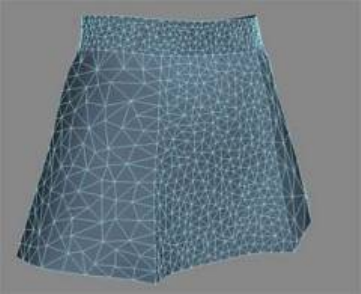
Density Controls the mesh density of a selected panel. This value is applied
as a multiplier of the Main Parameters rollout > Density setting on page 1244 .
You can increase the density of a particular panel by raising this value.
If Main Parameters rollout > Auto Mesh is off when you change this value, go
back to the Main Parameters rollout (Cloth level in modifier stack) and click
Mesh It! on page 1245 to update the mesh. For this reason, it is recommended
that you leave Auto Mesh on. The only time you might want to turn off Auto
Mesh is while creating the seams at the Curves sub-object level. Re-meshing
can take some time, so you might want to define a number of seams before
re-meshing.
Different Density settings applied to separate panels
Mat ID Set the material ID for the selected panel. Using this option enables
you to assign different materials to select portions of the clothing.
Position group
Reset Resets the position of the selected panels to their original locations
(that is, the locations immediately after Garment Maker was applied).
Reset All Resets the position of all panels to their original locations.
Deformation group
Most controls in this group are available only when one or more panels are
selected.
Reset Removes the deformation of the selected panels (restoring the flat
state).
Reset All Removes the deformation from all panels.
Cloth and Garment Maker Modifiers | 1253

Use Preserved Turn this on to override the None or Curved deformation
options. When on, the panel gets its shape from the preserved mesh instead
of the deformation options.
None Makes this panel flat.
Curved Use the value in the Curvature field to bend the panel.
Curvature Sets the amount of curve or bend of a panel. The higher this value
is, the more the panel will curve.
X-axis Sets the axis for the curvature to the panel's local X axis.
Y-axis Sets the axis for the curvature to the panel's local Y axis.
Panel Position Moves the selected panel to the position specified by the
button you click. These locations are determined by the software based on
the positions you set with the Mark Points On Figure on page 1247 controls at
the Garment Maker object level. The positions are:
■Front Center
■Front Right
■Front Left
■Back Center
■Back Right
■Back Left
■Right Side
■Left Side
■Right Arm
■Left Arm
NOTE The terms Front, Back, Right, and Left refer to the character's orientation.
Level Sets where the top of the panel should go. Garment Maker derives
these locations from the locations you specify with the Mark Points On Figure
on page 1247 controls. The choices are:
■Top at neck
■Top at shoulder
1254 | Chapter 9 Modifiers
■Top at underarm
■Top at waist
If you change the setting here, it affects the subsequent Panel Position results.
Adjusting Texture Coordinates
When Garment Maker is in Flat Panels mode (that is, the Main Parameters
rollout > Flat Panels option on page 1246 is chosen), the texture coordinates
are defined by the positions of the panels. Imagine the panels are being cut
out of a large piece of fabric. The location and orientation of a panel in that
large piece of fabric determine how the texture is aligned on it. By moving
and rotating a panel, you can change its texture coordinates. Remember, you
must be in Flat Panels mode to do this.
Seams rollout
At the Seams sub-object level, you can define and edit seams and their
properties. Seams have the same functionality as curves, but at this level the
mesh is displayed three-dimensionally instead of in a flat layout. Also, at this
level the mesh is always updated when you add or remove a seam.
Cloth and Garment Maker Modifiers | 1255
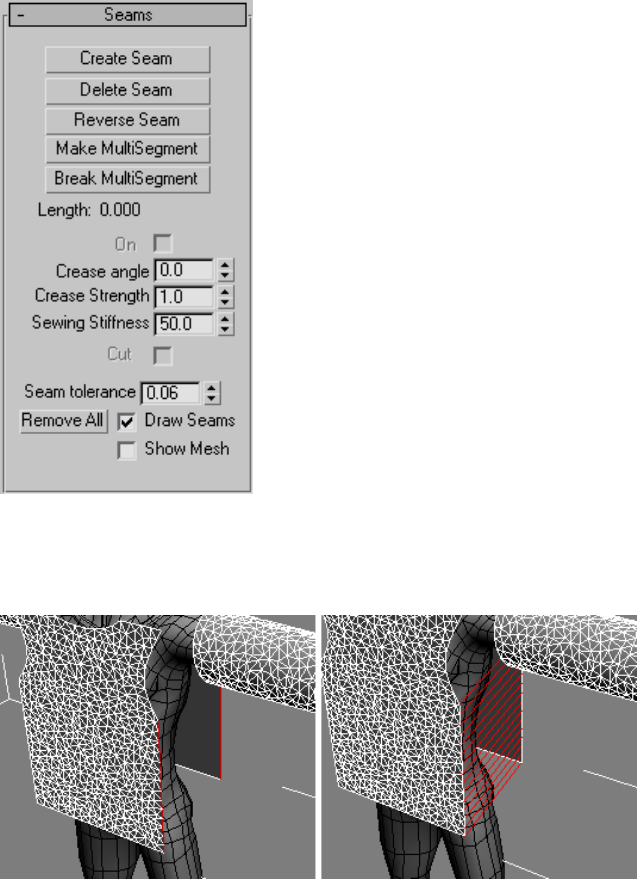
Create Seam Creates a seam between two segments. Select two segments of
the panels you would like to sew together and then click Create Seam. This
creates a seam between the two panels that will be sewn together at simulation
time.
Left: Segments selected
Right: Seam created between the two segments
Delete Seam Deletes selected seam. (Selected seam is colored red).
1256 | Chapter 9 Modifiers
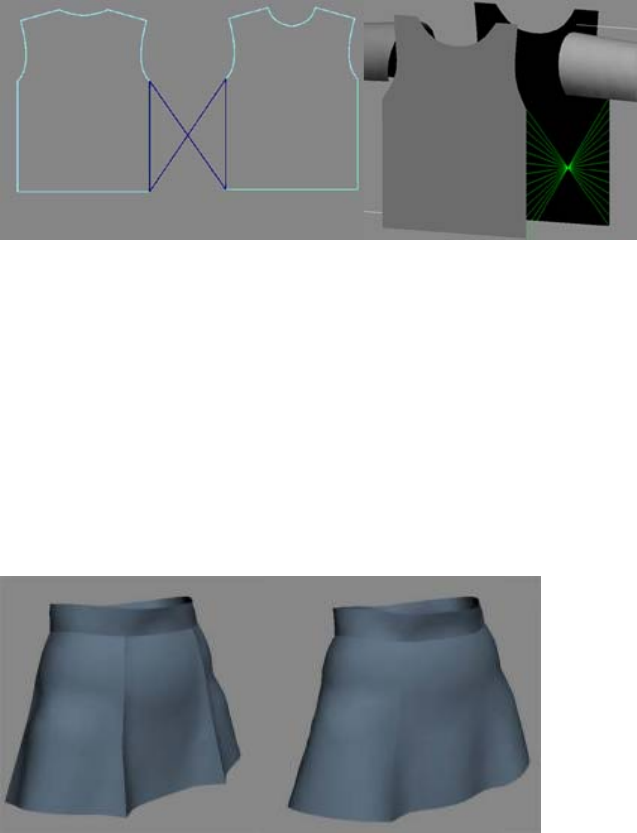
Reverse Seam Reverses or flips a seam that has been made with a twist in it.
When creating seams, the first vertex on each segment is used to line up the
resulting seam panel. Sometimes you can end up with a twisted seam and will
need to use Reverse Seam to untwist it.
A twisted seam that needs to be reversed
Make MultiSegment A MultiSegment is a combination of two or more
segments that will be treated as one segment for the purpose of creating seams.
Select the segments you want to combine then click this button. Note that if
the segments are not contiguous, the gaps must be bridged by seams before
this MultiSegment can be used in a seam.
Break MultiSegment Break apart selected MultiSegments.
On Turns the selected seam on or off, making it active or inactive.
Crease angle Creates a crease at the selected seam. The angle value determines
the target angle of the crease between the two panels or along an internal
seam line on page 1236 .
Left: High crease angle
Right: Low crease angle
Cloth and Garment Maker Modifiers | 1257
Crease Strength Specifies the strength of the selected seam. This value affects
the extent to which the seam resists bending in relation to the rest of the cloth
object. A value of 2.0 means that the cloth will have twice the resistance to
bending that it would otherwise have (as defined by the object/panel/vertex
group properties).
Sewing Stiffness The amount of force with which the panels are pulled
together at simulation time. A larger value will pull the panels together harder
and faster.
Cut This applies only to an internal seam line on page 1236 . Makes a cut in
the fabric at this seam line.
Seam Tolerance The amount of difference in length between two edges that
is permitted in the formation of a seam. The two segments that comprise a
seam should be about the same length. If they have different lengths, the
difference must be within this tolerance range. If you seam together two
segments that are significantly different in length, the cloth will tend to bunch
up (which may be a desired effect). In order to allow the creation of such a
seam, the Seam Tolerance will need to be increased. The default is 0.06, which
means that the two segment lengths must be within 6%.
Remove All Deletes all seams.
Draw Seams Shows the seams in the viewport; hides them when turned off.
Show Mesh Show the mesh in the viewport, or hide it to work on your
pattern. When this option is off, the mesh is represented with a bounding
box.
Troubleshooting and Error Codes in Garment
Maker
When you are working with Garment Maker, you may encounter errors if
your splines are set up incorrectly. Here is a list of the common error messages
you may see, and how to correct them.
Cannot remesh: the number of panels has changed: This error occurs when
the user has modified the original pattern, and added new closed splines to
it. The only way to correct this is to delete the original Garment Maker modifier
and reapply a new one.
Number of boundary curves has changed: Users will get this error if they add
or remove splines from the pattern after the initial application of Garment
1258 | Chapter 9 Modifiers
Maker. To correct it, delete the original Garment Maker modifier and reapply
a new one.
Boundary splines do not form a closed loop: In this case, the splines that the
user has tried to apply Garment Maker to don't form closed loops. Often, this
is caused by an extra vertex and segment attached to one of the splines, and
usually this segment is so small you cannot see it. It can be difficult to find
the offending part. To remedy this situation, select all the vertices, weld them,
then re-break them at the corners.
Splines form overlapping loops: When a user gets this error, it means that
some panel loops overlap others (in the XY plane of the local view). If you
create the shape in the Top view this should not happen (provided you don't
create overlapping loops). Most commonly, this occurs when the user create
the splines in a viewport other than Top and on a plane other than the XY
plane.
Unable to create seam: This error happens in when trying to create a seam in
two cases:
■One (or more) of the segments/MultiSegments in the attempted seam
forms a closed loop (for example, if you make a MultiSegment from the
armhole segments, that MultiSegment forms a closed loop if you create
seams at the shoulder and below the armhole). You will have to delete one
of the seams so that the MultiSegment is no longer closed. For an armhole,
you generally keep the seam below the armhole open when you join it
with the sleeve. You can then close the seam. For the same reason, the
sleeve cannot be seamed at the underside before joining to the armhole.
■A MultiSegment in the attempted seam contains segments that are not
contiguous and that are not linked by any seam.
CrossSection Modifier
Select a spline object with spline cross sections. > Modify panel > Modifier
List > CrossSection
Make a selection. > Modifiers menu > Patch/Spline Editing > CrossSection
The CrossSection modifier creates a "skin" across multiple splines. It works by
connecting the vertices of 3D splines to form a skin. The resulting object is
another spline object that can be used with the Surface modifier on page 1695
to create a patch surface. These two modifiers, when used together, are
sometimes referred to collectively as “Surface Tools.”
CrossSection Modifier | 1259
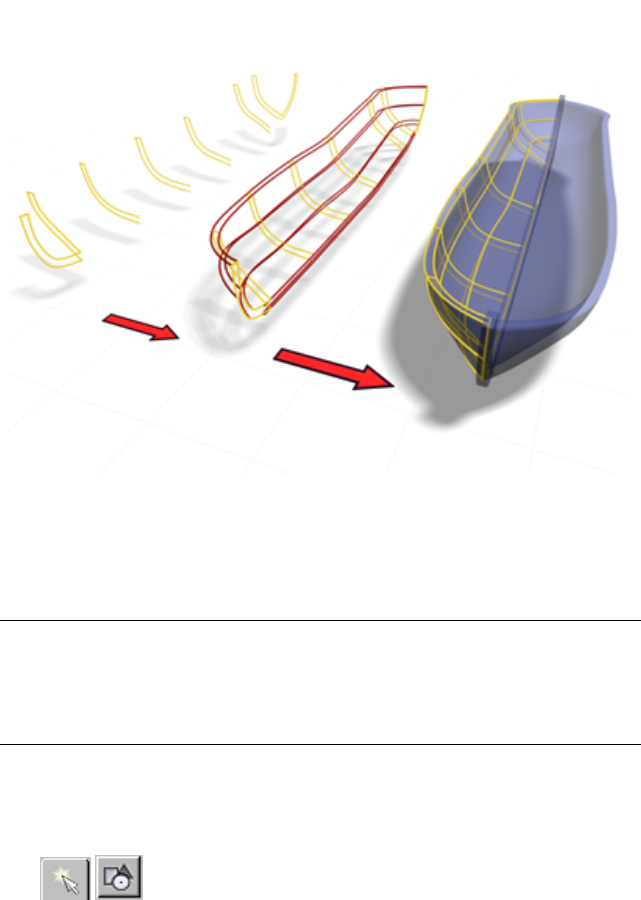
CrossSection uses splines to create a model of a boat.
CrossSection can build a skin across various-shaped splines with different
vertex counts and open/closed status. The more different the splines in vertex
count and complexity, the more likely the skin will have discontinuity.
NOTE Similar functionality is provided by the Editable Spline object on page 590
. At the Editable Spline > Segment and Spline sub-object levels, you can create a
spline cage using Connect Copy and Cross Section. Using this method, you need
to region-select the created vertices to transform them. Also, this method lets you
define the ordering of the spline more easily than does the CrossSection modifier.
Procedures
Example: To explore the CrossSection modifier:
1 On the Create panel, click Shapes, then click Circle.
2Drag in the Top viewport to create a circle about 100 units in radius.
1260 | Chapter 9 Modifiers
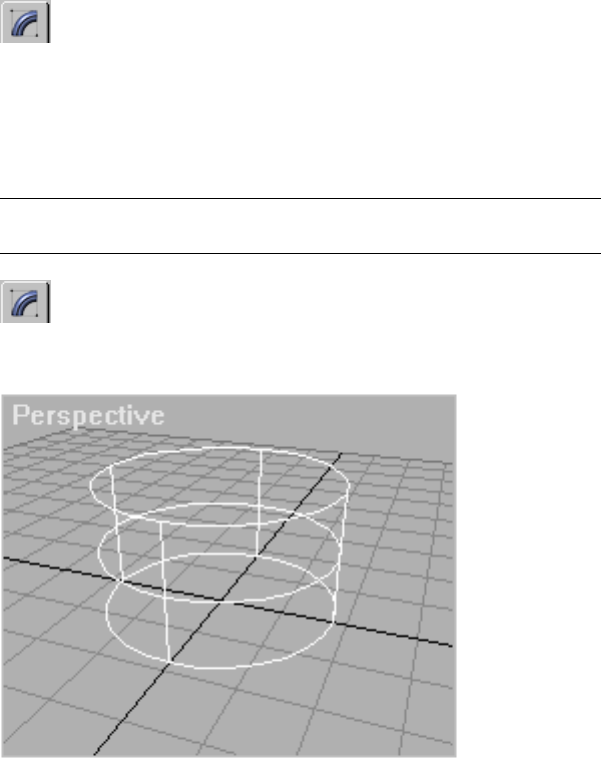
3 On the Modify panel, choose Edit Spline from the Modifier List.
4In the modifier stack display, turn on Spline sub-object, then select the
circle.
5In the Front viewport, Shift+Move the spline up to copy it.
6Shift+Move the copy up to create a third circle.
NOTE The order that you attach or clone splines is important: this is the
order that CrossSection uses to create the skin.
7 On the Modify panel, choose CrossSection from the Modifier List.
CrossSection joins the vertices of the three circles. A basic spline cylinder
is displayed.
8On the Modify panel, on the Modifiers List, choose Surface to add the
Surface modifier.
The spline cylinder is transformed into a patch surface by the Surface
modifier.
9To edit the model's surface, change the splines using controls in the Edit
Spline modifier. Or, since the output of the Surface modifier is a patch
surface, add an Edit Patch modifier and use patch edit controls to change
the surface.
CrossSection Modifier | 1261
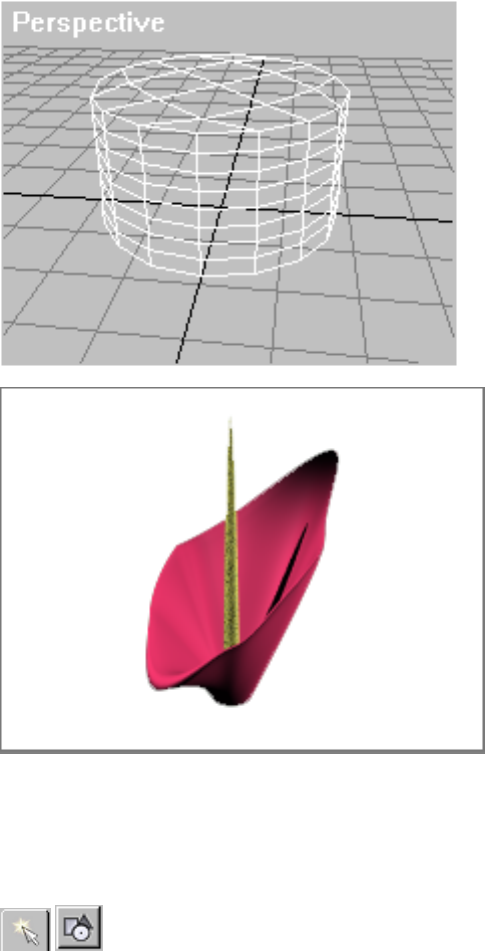
An Edit Patch modifier above the Surface modifier was used to create the image.
Example: Using the CrossSection modifier to skin several splines with different
shapes:
1 On the Create panel, click Shapes.
2On the Object Type rollout, turn on Start New Shape, then click NGon.
1262 | Chapter 9 Modifiers
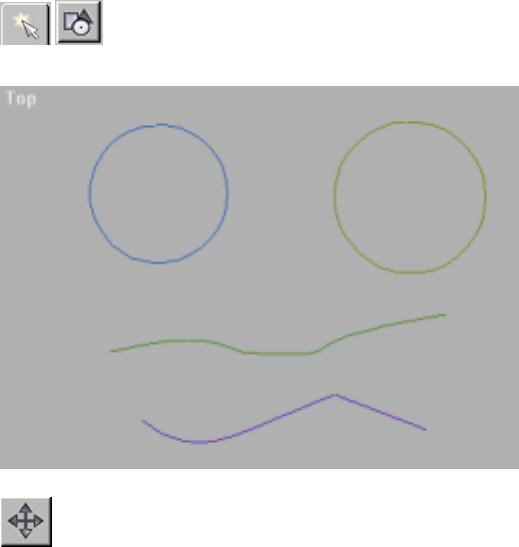
3In the Top viewport, create two five-sided circular NGons.
4 On the Create panel, with Shapes still active, click Line.
Create two lines, each with four vertices. Create the vertices left-to-right.
5 On the main toolbar, click Select And Move, then move the objects
in the viewport to order them along the Z axis with the NGons at the
bottom and the lines above the NGons.
CrossSection Modifier | 1263
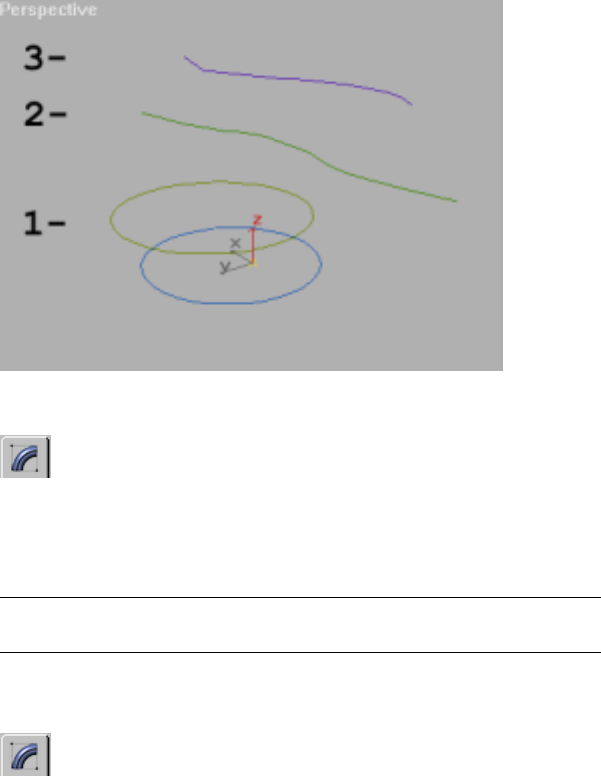
6Select the bottom NGon.
7 On the Modify panel, choose Edit Spline from the Modifier List.
8In the Geometry rollout, click Attach.
9Select the remaining NGon and lines in an ascending order, as numbered
in the image.
NOTE The order of selection is important. The CrossSection modifier uses
the selection order to define the skin.
Example continued: Lining up the vertices:
1 On the Modify panel, choose the Vertex sub-object level in the
stack display.
Lining up the first vertex of each spline is important to prevent the surface
from twisting.
2Use Ctrl+click to select the rightmost vertex of each line and the
bottommost vertex of each NGon.
3On the Geometry rollout, click Make First.
1264 | Chapter 9 Modifiers
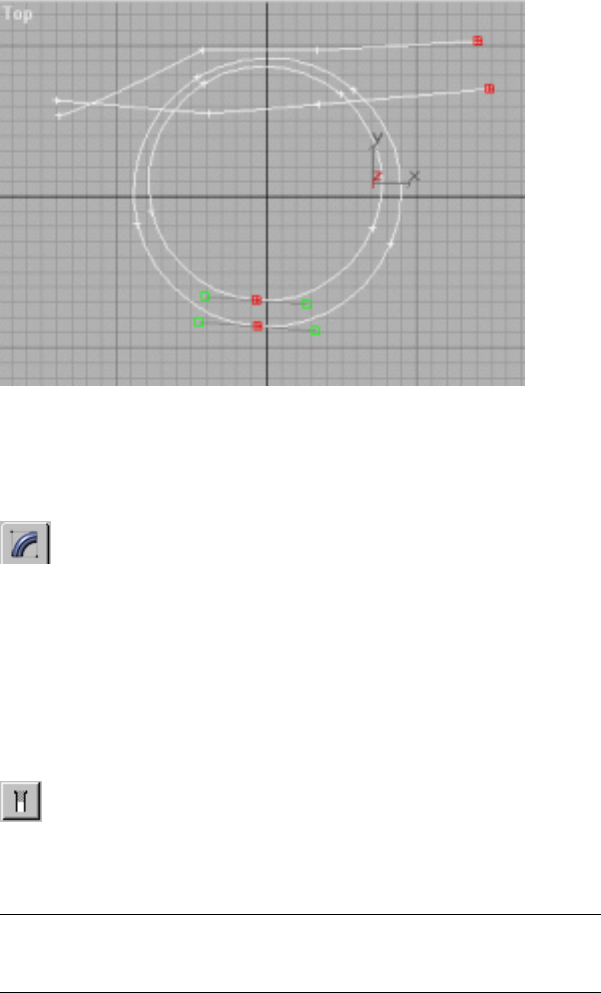
Aligning the first vertex is important. This is where the seam forks, going
from a closed to an open spline.
Example continued: Using CrossSection and Surface to "skin" the shapes:
1 On the Modify panel, choose CrossSection from the Modifier List.
The CrossSection modifier connects the splines at the vertices.
2On the Modifiers List, choose Surface.
The Surface modifier generates a patch surface based on the splines.
3In the modifier stack display, choose the CrossSection modifier.
4On the CrossSection Parameters rollout, toggle between Linear and
Smooth. Notice how the splines change.
5 On the Modify panel, toggle the Show End Result On/Off Toggle
button to display the final patch surface. The toggle won’t remain on if
the CrossSection modifier is current. Drop down to the Editable Patch in
the stack and turn on the Show End Result toggle if you like.
TIP When you use CrossSection, draw splines in a consistent direction. A
twisted surface results when lines are created from vertices that are not lined
up.
CrossSection Modifier | 1265
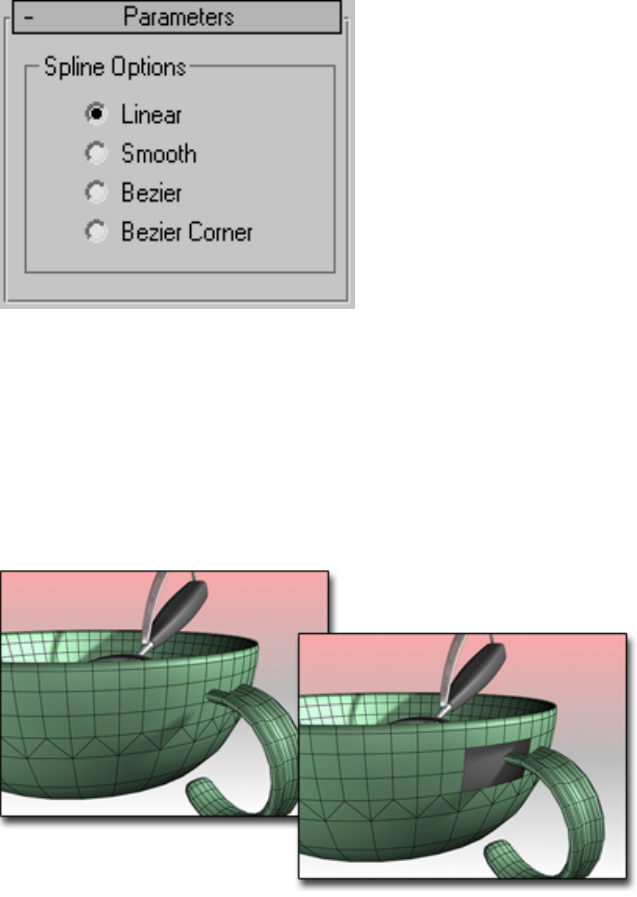
Interface
Linear/Smooth/Bezier/Bezier Corner Determines what type of curve will be
used through the spline vertices.
Delete Mesh Modifier
Modify panel > Make a sub-object selection. > Modifier List > Delete Mesh
Modify panel > Make a sub-object selection. > Modifiers menu > Mesh Editing
> Delete Mesh
Delete Mesh used to remove the faces where the handle joins the cup.
1266 | Chapter 9 Modifiers
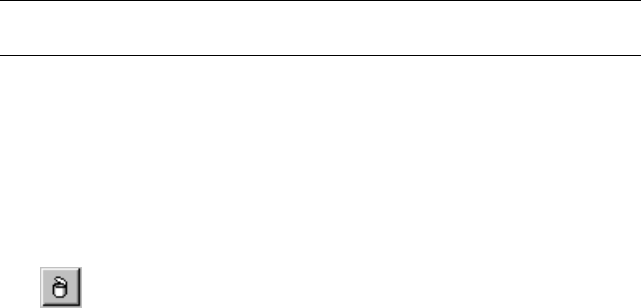
Delete Mesh provides parametric deletion based on the current sub-object
selection level in the stack. The possible choices are faces, vertices, edges, and
objects. Apply the Delete Mesh modifier to delete the geometry specified at
that sub-object level.
For example, you can apply a Mesh Select modifier on page 1455 , select a row
of faces in a cylinder, and then apply a Delete Mesh modifier to delete those
faces. To undo the deletion, you can simply remove the Delete Mesh modifier.
TIP Try applying a Delete Mesh modifier following an animated Vol. Select
modifier on page 1910 .
Procedures
Example: To delete a row of faces in a cylinder:
1Create a cylinder on page 364 .
2Apply a Mesh Select modifier and select a row of faces in the cylinder.
3Apply the Delete Mesh modifier to delete those faces.
To undo the deletion, remove the Delete Mesh modifier.
Interface
This modifier has no parameters.
Delete Patch Modifier
Modify panel > Make a patch selection. > Modifier List > Delete Patch
Make a selection. > Modifiers menu > Patch/Spline Editing > Delete
Delete Patch provides parametric deletion based on the current sub-object
level in the stack. The possible choices are vertices, edges, patches, and
elements. Apply the Delete Patch modifier to delete the geometry specified at
that sub-object level.
For example, you can apply a Patch Select modifier, select a row of patches in
a patch sphere, and then apply a Delete Patch modifier to delete those patches.
To undo the deletion, remove the Delete Patch modifier.
Delete Patch Modifier | 1267
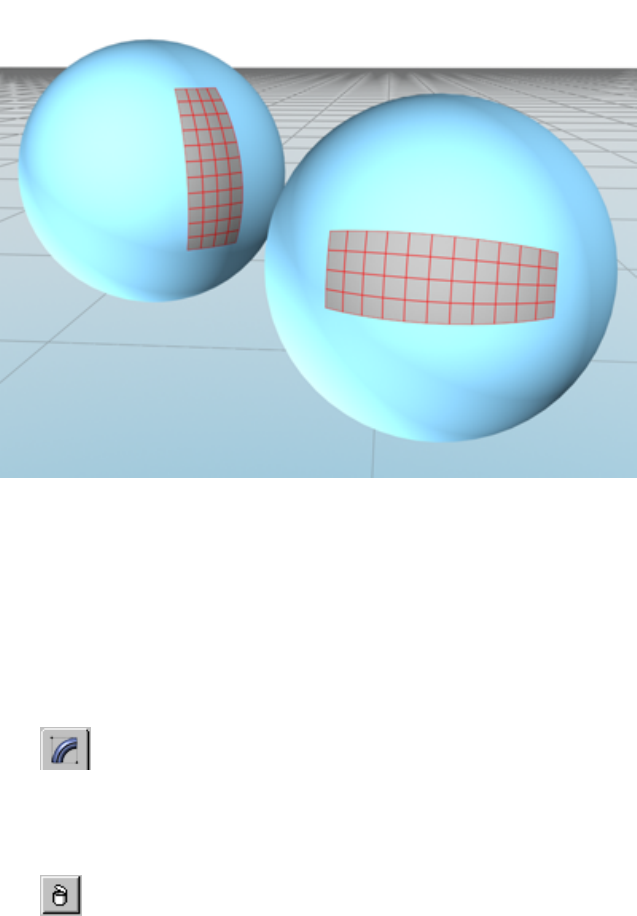
Delete Patch used to remove sections of a patch sphere.
Procedures
Example: To delete a patch in a sphere:
1Create a sphere.
2Right-click the sphere, and choose Convert To > Convert To Editable
Patch on the quad menu.
3 On the Modify panel, in Editable Patch, choose the Patch sub-object
level, and select a patch.
4In the Modifier List, choose the Delete Patch modifier.
This deletes the selected patch.
To undo the deletion, remove the Delete Patch modifier.
1268 | Chapter 9 Modifiers
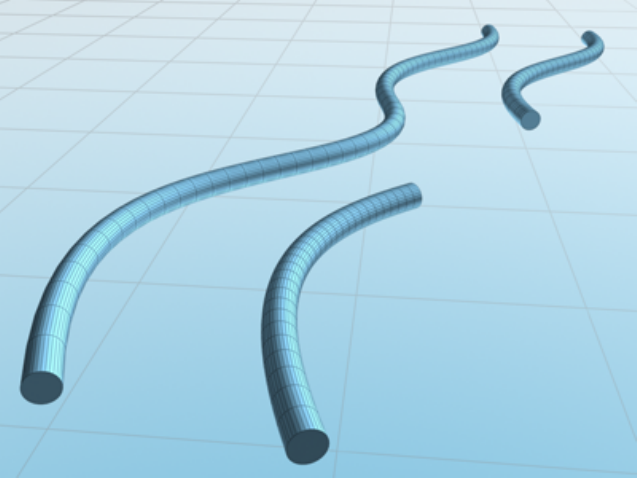
Interface
There are no parameters for this modifier.
Delete Spline Modifier
Modify panel > Select a spline sub-object. > Modifier List > Delete Spline
Modify panel > Select a spline sub-object. > Modifiers menu > Patch/Spline
Editing > Delete Spline
The Delete Spline modifier provides parametric deletion of spline geometry
based on the current sub-object selection level in the stack. The possible
selection levels include vertices, segments, and splines. Apply the Delete Spline
modifier to delete the geometry specified at that sub-object level.
Delete Spline used to remove a segment in the middle of a spline.
Delete Spline Modifier | 1269

Procedures
To use the delete spline modifier:
1Create a shape that contains multiple splines.
2Apply a Spline Select modifier on page 1673 and select a section of the
spline for deletion.
3Apply a Delete Spline modifier to delete the section.
To undo the deletion, remove the Delete Spline modifier.
Interface
This modifier has no parameters.
Disp Approx Modifier
Modify panel > Make a selection. > Modifier List > Object-Space Modifiers >
Disp Approx
Make a selection. > Modifiers menu > Surface Deformers > Disp Approx
Make a selection. > Modifiers menu > NURBS Editing > Disp Approx
The Disp Approx modifier (short for Displacement Approximation) lets you
make the displacement mapping settings on an object in the modifier stack
on page 7427 . It converts its input object to an editable mesh on page 1990 , so
you can use this modifier to add displacement mapping to geometry primitives
on page 348 and any other kind of object that can convert to an editable mesh.
1270 | Chapter 9 Modifiers
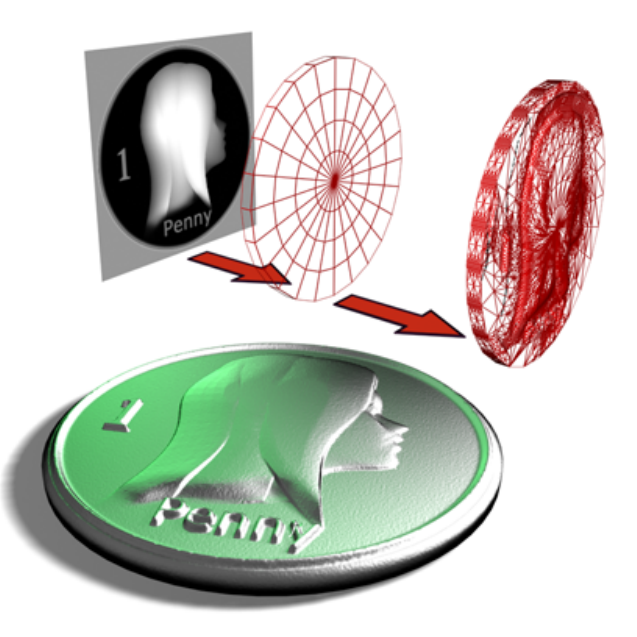
Using an image to displace the surface of a cylinder
Displacement mapping on page 5391 uses a map to change surface geometry.
You apply the map using the Material Editor on page 5188 .
You don't need to apply this modifier to NURBS on page 2152 surfaces, patches
on page 1982 , editable meshes on page 1990 , or editable polymeshes on page
2038 , because you can apply displacement mapping directly to these kinds of
objects.
Procedures
To apply displacement mapping:
1Select an object other than a NURBS surface, patch, editable mesh, or
editable poly.
Disp Approx Modifier | 1271

2Apply the Disp Approx modifier.
Now you can apply displacement mapping to the object. The
Displacement Approx. rollout has parameter that you can adjust, but
displacement mapping will work using the default settings.
3 Go to the Material Editor. Apply a Standard material to the object.
4In the material's Maps rollout, click the Displacement button, then use
the Material/Map Browser to apply a displacement map.
1272 | Chapter 9 Modifiers
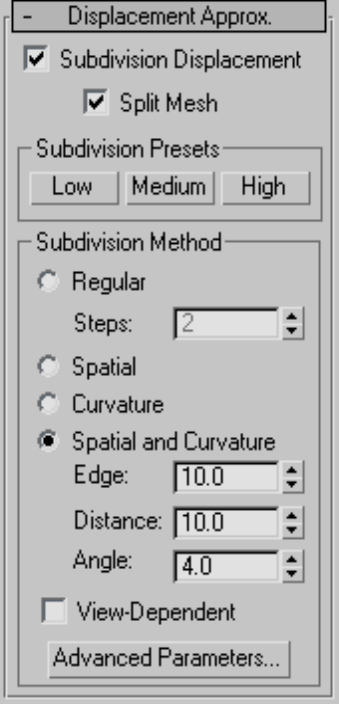
Interface
Subdivision Displacement Subdivides mesh faces to accurately displace the
map, using the method and settings you specify in the Subdivision Presets
and Subdivision Method group boxes. When turned off, the modifier applies
the map by moving vertices in the mesh, the way the Displace modifier on
page 1274 does. Default=on.
Split Mesh Affects the seams of displaced mesh objects; also affects texture
mapping. When on, the mesh is split into individual faces before displacing
them; this helps preserve texture mapping. When off, texture mapping is
assigned using an internal method. Default=on.
Disp Approx Modifier | 1273
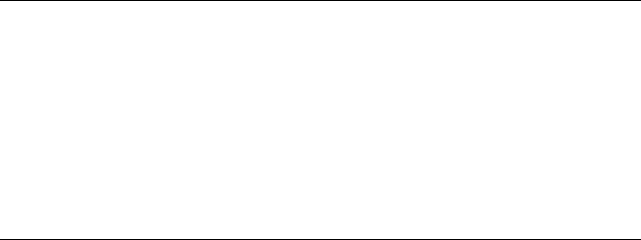
TIP This parameter is required because of an architectural limitation in the way
displacement mapping works. Turning Split Mesh on is usually the better technique,
but it can cause problems for objects with clearly distinct faces, such as boxes, or
even spheres. A box's sides might separate as they displace outward, leaving gaps.
And a sphere might split along its longitudinal edge (found in the rear for spheres
created in the Top view) unless you turn off Split Mesh. However, texture mapping
works unpredictably when Split Mesh is off, so you might need to add a Displace
Mesh modifier on page 1045 and make a snapshot on page 921 of the mesh. You
would then apply a UVW Map modifier on page 1849 and then reassign mapping
coordinates to the displaced snapshot mesh.
Subdivision Presets and Subdivision Method group boxes
The controls in these two group boxes specify how the modifier applies the
displacement map when Custom Settings and Subdivision Displacement are
both turned on. They are identical to the Surface Approximation controls on
page 2469 used for NURBS surfaces.
Displace Modifier
Modify panel > Make a selection. > Modifier List > Object-Space Modifiers >
Displace
Make a selection. > Modifiers menu > Parametric Deformers > Displace
The Displace modifier acts as a force field to push and reshape an object's
geometry. You can apply its variable force directly from the modifier gizmo,
or from a bitmapped image.
1274 | Chapter 9 Modifiers
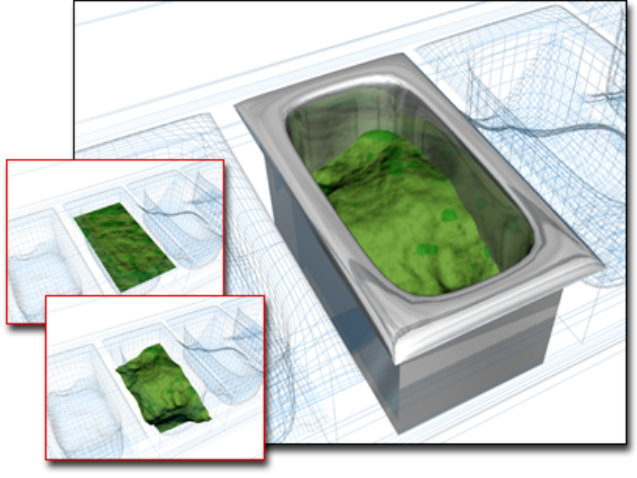
Displace used to change the surface in the container
There are two basic ways to use the Displace modifier:
■Apply displacement effects directly by setting Strength and Decay values.
■Apply the grayscale component of a bitmapped image to generate the
displacement. Lighter colors in the 2D image push outward more strongly
than darker colors, resulting in a 3D displacement of the geometry.
The Displace space warp on page 2645 has similar features. It's useful for
applying effects to a large number of objects or a particle system.
Displace Modifier | 1275
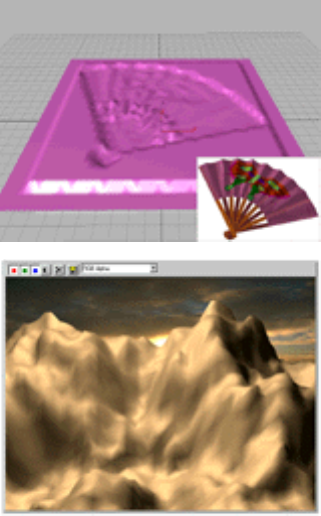
Top: Bitmap displacement on a patch and the bitmap used.
Bottom: Terrain effects using Displace
Force Distribution
Displace distributes its force through four different gizmos: Planar, Cylindrical,
Spherical, and Shrink Wrap. Gizmos are also used as mapping coordinates for
applying bitmaps. Sphere and Shrink Wrap have the same effect when
modeling, but differ in the way they map.
The Spherical and Shrink Wrap gizmos begin with a uniform field around
them. The Cylinder and Planar gizmos are both directional. Cylinder pushes
at right angles to its axis, and Planar pushes at right angles to its surface.
By default, gizmos are centered on the object. However, you can transform
any of these shapes and use it directly as a tool to deform the geometry of an
object.
1276 | Chapter 9 Modifiers
Modeling Options
Displace is a versatile modifier with many possible applications. Here are some
options:
■Produce interior modeling effects by scaling down the gizmo and moving
it inside the object. The outward force shapes the geometry from within.
■Animate the modeling process. One result is a roving, magnetic-like field
that pushes and pulls on a surface.
■Add additional Displace modifiers to an object, using each one to create
a different modeling effect.
■Collapse a finished model into a plain mesh. This reduces the object's
complexity and removes all modifiers, but keeps the modeled surface intact.
Procedures
To displace an object:
1Select an object and apply the Displace modifier.
2In the Parameters rollout > Map group, select one of the four gizmo types.
3In the Displacement group, set values for Strength and Decay. Vary these
settings to see the effect of the displacement on the object.
Depending on the object and the complexity of the bitmap, you might need
to use dense geometry to see the effect clearly. Try a test run and, if necessary,
add tessellation in the areas of greatest detail.
To apply a bitmap as a displacement map:
1In the Parameters rollout > Image group, click the Bitmap button (which
is labeled "None" until a map has been chosen). Use the file dialog to
choose a bitmap.
2Adjust the Strength value. Vary the strength of the field to see the effect
of the bitmap displacing the object's geometry.
After you get the image you want from bitmapped displacement, you can
apply an Optimize modifier on page 1515 to reduce the complexity of the
geometry while retaining the detail.
Displace Modifier | 1277
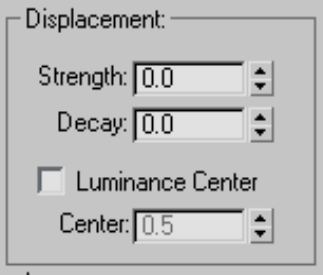
To model with the displace modifier:
1Apply Displace to the object you want to model. Choose a gizmo from
the Map group.
2Increase the Strength setting until you begin to see a change in the object.
3Scale, rotate, and move the gizmo to concentrate the effect. As you do
this, adjust the Strength and Decay settings to fine-tune the effect.
Interface
Displacement group
Strength When set to 0.0, Displace has no effect. Values greater than 0.0
displace object geometry or particles away from the position of the gizmo.
Values less than 0.0 displace geometry toward the gizmo. Default=0.0.
Decay Varies the displacement strength with distance.
By default, Displace has the same strength throughout world space. Increasing
Decay causes the displacement strength to diminish as distance increases from
the position of the Displace gizmo. This has the effect of concentrating the
force field near the gizmo, similar to the field around a magnet repelling its
opposite charge. Default=0.0.
Luminance Center Determines which level of gray Displace uses as the zero
displacement value.
By default, Displace centers the luminance by using medium (50 percent) gray
as the zero displacement value. Gray values greater than 128 displace in the
outward direction (away from the Displace gizmo) and gray values less than
128 displace in the inward direction (toward the Displace gizmo). Use the
1278 | Chapter 9 Modifiers
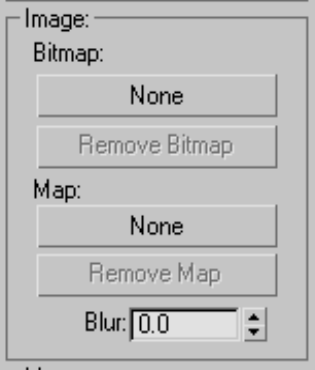
Center spinner to adjust the default. With a Planar projection, the displaced
geometry is repositioned above or below the Planar gizmo. Default=0.5.
Range=0 to 1.0.
Image group
Lets you choose a bitmap on page 7730 and map on page 7840 to use for
displacement. Both are assigned and removed in the same way.
Bitmap button Assigns a bitmap or map from a selection dialog. After you
make a valid choice, these buttons display the name of the bitmap or map.
This button is labeled "None" until you choose a map.
Remove Bitmap/Map Removes the bitmap or map assignment.
Blur Increase this value to blur or soften the effect of the bitmapped
displacement.
Displace Modifier | 1279
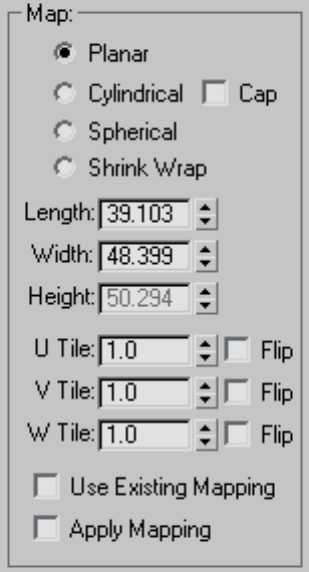
Map group
Contains mapping parameters for bitmapped displacement. See UVW Map
modifier on page 1849 .
The four mapping modes control how Displace projects its displacement. The
type of Displace gizmo and its location in the scene determine the final effect.
1280 | Chapter 9 Modifiers
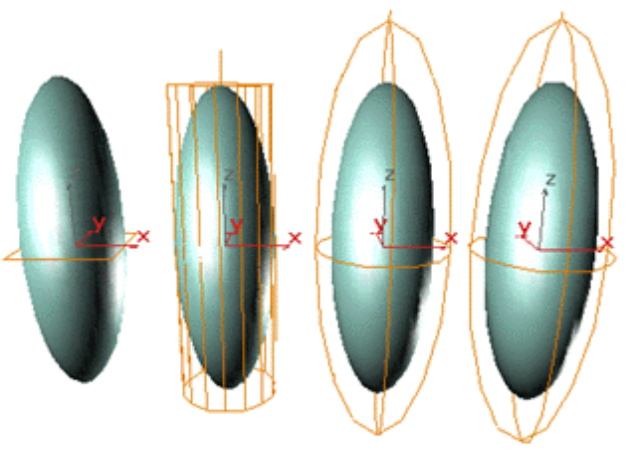
Displace gizmos: Planar, Cylindrical, Spherical, and Shrink Wrap
Planar Projects the map from a single plane.
Cylindrical Projects the map as if it were wrapped around the cylinder. Turn
on Cap to project a copy of the map from the ends of the cylinder.
Spherical Projects the map from a sphere, with singularities at the top and
bottom of the sphere where the bitmap edges meet at the sphere's poles.
Shrink Wrap Projects the map from a sphere, as Spherical does, but truncates
the corners of the map and joins them all at a single pole, creating only one
singularity at the bottom.
Length, Width, Height Specifies the dimensions of the Displace gizmo's
bounding box. Height has no effect on Planar mapping.
U/V/W Tile Sets the number of times the bitmap repeats along the specified
dimension. The default value of 1.0 maps the bitmap exactly once; a value of
2.0 maps the bitmap twice, and so on. Fractional values map a fractional
portion of the bitmap in addition to copies of the whole map. For example,
a value of 2.5 maps the bitmap two and a half times.
Flip Reverses the orientation of the map along the corresponding U, V, or
W axis.
Displace Modifier | 1281
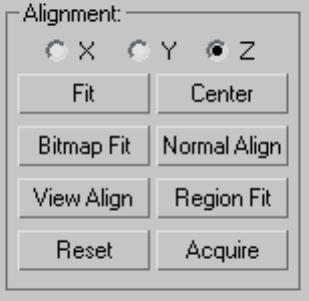
Use Existing Mapping Has Displace use mapping set earlier in the stack. This
has no effect if the object is not mapped.
Apply Mapping Applies the Displace UV mapping to the bound object. This
lets you apply material maps to the object using the same mapping coordinates
as the modifier.
Channel group
Specifies whether to apply the displacement projection to a mapping channel
or a vertex color channel, and which channel to use. For more information
on these channels, see UVW Map modifier on page 1849 .
Map Channel Choose this to specify a UVW channel to use for the mapping,
and use the spinner to its right to set the channel number.
Vertex Color Channel Choose this to use the vertex color channel for the
mapping.
Alignment group
Contains controls for adjusting the mapping gizmo's size, position, and
orientation.
X, Y, Z Flips the alignment of the mapping gizmo along its three axes.
Fit Scales the gizmo to fit the object's bounding box.
Center Centers the gizmo relative to the object's center.
Bitmap Fit Displays a Select Bitmap dialog. The gizmo is scaled to fit the
aspect ratio of the bitmap you select.
1282 | Chapter 9 Modifiers
Normal Align Turns on Pick mode to let you select a surface. The gizmo is
aligned to the normal of that surface.
View Align Orients the gizmo in the same direction as the view.
Region Fit Turns on Pick mode to let you drag two points. The gizmo is
scaled to fit the specified area.
Reset Returns the gizmo to its defaults.
Acquire Turns on Pick mode to let you choose another object and acquire
its Displace gizmo settings.
Edit Mesh Modifier
Create or select an object > Modify panel > Modifier List > Object–Space
Modifiers > Edit Mesh
Create or select an object > Modifiers menu > Mesh Editing > Edit Mesh
The Edit Mesh modifier provides explicit editing tools for different sub-object
levels of the selected object: vertex, edge, and face/polygon/element. The Edit
Mesh modifier matches all the capabilities of the base Editable Mesh object,
except that you cannot animate sub-objects in Edit Mesh. See Editable Mesh
on page 1990 for a complete parameter reference.
When possible, it’s far more efficient and reliable to perform explicit modeling
at the Editable Mesh level rather than store those edits within the Edit Mesh
modifier. The Edit Mesh modifier must copy the geometry passed to it, and
this storage can lead to large file sizes. The Edit Mesh modifier also establishes
a topological dependency that can be adversely affected if earlier operations
change the topology being sent to it.
There are, however, situations where using the Edit Mesh modifier is the
preferred method.
■You want to edit a parametric object as a mesh, but want to retain the
ability to modify its creation parameters after the edit.
■You want to store your edits temporarily within Edit Mesh until you are
satisfied with the results, before collapsing them permanently to an editable
mesh object.
■You need to make edits across several objects at once, but do not want to
convert them to a single editable mesh object.
Edit Mesh Modifier | 1283
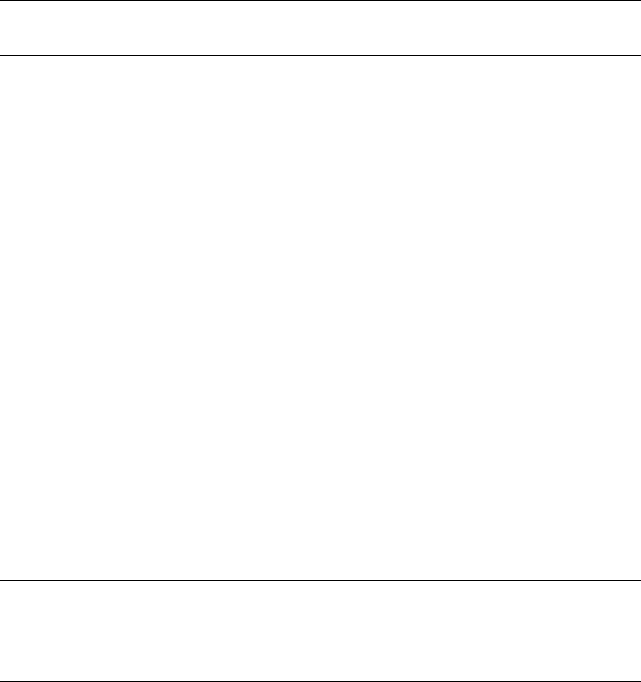
■You have a modifier in the stack that must remain parametric, and the
mesh must be edited after the modifier is applied.
NOTE Collapsing an object that has an Edit Mesh modifier applied to it results in
an Editable Mesh object.
Edit Normals Modifier
Select a mesh, patch, spline or NURBS object. > Modify panel > Modifier List
> Edit Normals
Select a mesh, patch, spline, or NURBS object. > Modifiers menu > Mesh Editing
> Edit Normals
The Edit Normals modifier gives you explicit and procedural, interactive
control over each of an object's vertex normals on page 7863 . It is meant to be
used primarily with mesh objects destined for output to game engines and
other 3D rendering engines that support specified normals. The results are
visible in the viewports and in rendered images.
The orientation of a vertex normal affects how neighboring surfaces reflect
light. By default, normals are set so that reflection of light in 3ds Max follows
the rules of real-world physics: The angle of reflection equals the angle of
incidence. But by reorienting vertex normals, you can set the angle of reflection
to be anything you want. The Edit Normals modifier lets you specify vertex
normals' directions, combine and separate them, change the type, and copy
and paste values among normals.
WARNING Don't apply an Edit Normals modifier to the low-res object used in
normal bump projection on page 6182 . Normal bump projection relies on the
low-res object having standard normals, and altering them causes normal bump
maps to have unpredictable results.
Types of Normals
Three types of normals are available with the Edit Normals modifier:
■Unspecified: These are the normals that the modifier derives from
smoothing groups and initially assigns to the modified mesh vertices. The
software calculates the direction of an unspecified normal based on the
average facing of all polygons to which it belongs that are in its smoothing
group.
1284 | Chapter 9 Modifiers
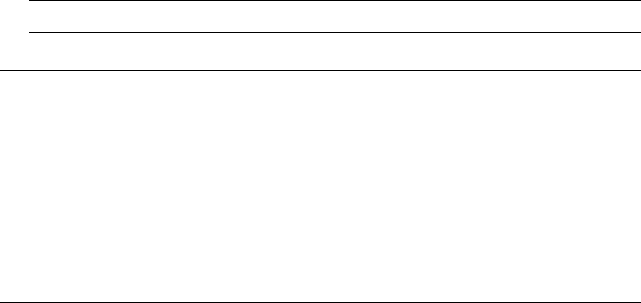
By default, each vertex has as many normals as the number of unique
smoothing groups used by surrounding polygons. For example, each side
of a box uses a different smoothing group by default, so each vertex at
which three sides meet (typically a corner) has three different normals:
one perpendicular to each of the three sides. On the other hand, a sphere
uses a single smoothing group, so each of its vertices has one normal,
perpendicular to the average facing of the polygons that share it. By default,
unspecified normals are displayed as blue.
■Specified: These are normals that are intended for use by particular corners
of particular faces, without regard to smoothing groups. For instance, you
might create a box, apply Edit Normals, select a group of normals at a
particular vertex, and click Unify. Now those three faces are told specifically
to use that one unified normal, and they ignore their smoothing groups
at that vertex. But specified normals are not set to explicit values; they
ignore smoothing groups, but they're still based on the face normals of
the faces that use them. Specified normals are displayed as cyan.
■Explicit: These are normals that are set to particular values. For instance,
if you use the Move or Rotate command to change a normal from its default
value, it has to be made explicit, so it won't be recomputed based on the
face normals. Explicit normals are green by default.
NOTE Explicit normals are also considered to be specified.
NOTE A selected normal is always red. When not selected, its color indicates as
type, as noted above. You can find the customizable color entries on page 7505
for these normal types in the Elements > Geometry list. The three entry names
are:
■Normals - Explicit
■Normals - Specified
■Normals - Unspecified
Usage Examples
Following are two instances in which a 3D artist creating content for output
to a game engine might find practical use for the Edit Normals modifier:
■An artist is working on a knight with a chrome shield. The chrome shield
has a DirectX cube map shader on page 7925 on it so that the artist can see
Edit Normals Modifier | 1285
the reflections in the viewport. The artist would like to make the reflections
in the shield look "dented" by fights in battle. The artist applies the Edit
Normals modifier to the shield object. He then adjusts several of the
normals slightly, viewing the results in real time, thanks to the pixel shader.
He then exports the character with a custom export tool designed to handle
normal information.
■A game artist is working on an object that will explode in the game. To
do this, the game engine requires the object to be split into multiple objects:
the broken pieces that will result from the explosion. When the object is
broken apart in 3ds Max (using Slice), the normals are pointing in different
directions; this makes it easy to see the seams between the broken pieces.
To fix this, the artist selects all the pieces of the breaking object and applies
the Edit Normal modifier to all of them at once. She then selects the
normals across the seam and unifies them so they are pointing in the same
direction. The artist then exports to the game engine.
Usage Notes
Please observe the following notes and precautions when using the Edit
Normals modifier:
■Edit Normals supports both poly objects (polygon-based) and mesh objects
(triangle-based). If you apply Edit Normals to a poly object, the result is a
poly object. If you apply Edit normals to any other object type, the result
is a mesh object.
■Edit Normals also supports embedding of edited-normal data when
collapsing the stack, and when converting from poly object to mesh object,
but not when converting from a mesh object to any other object type. If
you apply Edit Normals to a primitive object, adjust the normals, and then
collapse the stack (or convert to Editable Mesh), the software embeds any
changes to the normals in the mesh object, including selection status.
Primitive objects are mesh-based, so if you convert the same object to
Editable Poly, the edited normals are lost. On the other hand, if you convert
a primitive object to Editable Poly, apply Edit Normals, adjust the normals,
and then collapse the stack, resulting in a poly object, the normals are
retained. You can subsequently regain access to embedded, edited normals
in a collapsed object by applying another Edit Normals modifier.
■Any modifiers that change topology will remove changes applied to the
normals with the Edit Normals modifier. These include MeshSmooth,
Tessellate, Slice, Mirror, Symmetry, Face Extrude, and Vertex Weld. Oddly
enough, it also means that the Normal modifier (used to flip face
1286 | Chapter 9 Modifiers
orientations) will not support the edited normals. Since Turn To Poly can
be used to modify face topology, it also strips off the edited normals.
■All compound objects strip off the edited normals from their operands.
■The good news: All deformation and map modifiers preserve the normals.
For instance, if you apply a Bend, the normals should be bent along with
the geometry. Map modifiers, such as Unwrap UVW, won't affect the
normals at all.
■However, a few geometric modifiers do not fully support the new normals.
They won't strip them away, but neither will they correctly deform any
explicit normals. Modifiers in this category include Push and Relax.
■The Smooth modifier correctly modifies any non-specified normals, while
leaving the specified and explicit normals alone.
■Like Mesh Select and Poly Select, Edit Normals “inherits” attributes from
below it in the stack. For example, if you create a box, apply an Edit
Normals modifier, change some normals, and then apply a second Edit
Normals modifier, the top Edit Normals "inherit" the user-specified normals
from the pipeline, just as Mesh Select adopts the current selection when
you apply it. But the top Edit Normals modifier ignores any subsequent
changes to the original Edit Normals modifier, just as Mesh Select ignores
any changes made to the selection below it in the stack after it is applied.
Edit Normals Modifier | 1287
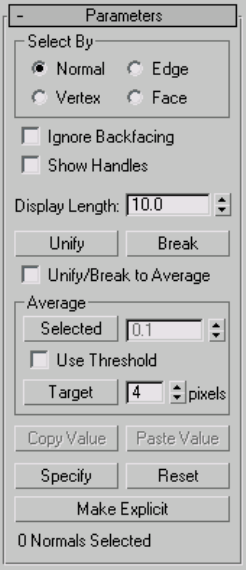
Interface
The Edit Normals modifier is useful mainly at the sub-object level, Normal,
so this level is active by default as soon as you apply the modifier to an object.
At this point, you can see the normals as lines emanating from the mesh
vertices, select and transform them, copy and paste them, and change their
settings on the Modify panel.
You can transform normals only by moving and rotating them, not by scaling
them. However, moving a normal effectively rotates it, so in most cases you'll
have better control by using the Rotate tool.
The following command reference includes keyboard shortcuts, which are
available when the Keyboard Shortcut Override Toggle on page 7646 (on the
toolbar) is on. In addition, you can use Ctrl+0 (zero) to access the object level
of the modifier.
Select By group Lets you specify how to select normals in the viewport:
■Normal (Ctrl+1): Click a normal to select it.
1288 | Chapter 9 Modifiers
■Vertex (Ctrl+2): Click a mesh vertex to select all of its normals.
■Edge (Ctrl+3): Click a mesh edge to select the normals associated with the
neighboring polygons.
■Face (Ctrl+4): Click a mesh face (or polygon) to select the associated
normals.
Of course, with all of these methods, you can also use region selection to select
multiple normals at once.
Ignore Backfacing When on, selection of sub-objects affects only those facing
you. When off (the default), you can select any sub-object(s) under the mouse
cursor, regardless of their visibility or facing. If there are more than one
sub-object under the cursor, repeated clicking cycles through them. Likewise,
with Ignore Backfacing off, region selection includes all sub-objects, regardless
of the direction they face.
Show Handles Enables the display of handles, which are small squares at
the end of each normal. Turn this on to make it easier to select normals.
Display Length Specifies the length of each normal. This is for display
purposes only; the length has no effect on the normal's functionality.
Unify (U)Combines all selected normals at each vertex into a single specified
normal on page 1284 . By default, with Unify/Break To Average off, Unify sets
the direction for each unified normal to be perpendicular to the averaged
surface at that point. With Unify/Break To Average on, Unify sets the direction
be the average of the combined normals at each location.
Break (B)Separates all selected, unified normals into their original
components. With Unify/Break To Average off, Break orients each separated
normal perpendicular to its respective face, thus splaying out the normals at
each vertex if the connected faces are at different angles (as with a sphere).
With Unify/Break To Average on, each separated normal uses the orientation
of the original normal.
Break converts any selected normals to specified normals.
Unify/Break to Average Determines normal orientation as the result of a
Unify or Break operation. See the descriptions above for details. Default=off.
Average group
These controls give you different methods of averaging vertex normals; that
is, setting them all to the same absolute angle, which is the average of their
combined angles.
Edit Normals Modifier | 1289
Selected Sets selected normals to the same absolute angle: the average angle
of all of them. If Use Threshold is on, averages only normals whose distance
from each other is less than that specified in the Average Threshold spinner
(to the button's right).
Use Threshold Activates the Average Threshold setting, and causes the
Selected to average only normals whose distance from each other is less than
the specified value.
Target Enters an interactive mode in which you specify pairs of normals to
average. Click Target, and then select a normal. When the mouse cursor is
over a normal, it changes to a + cursor. After clicking the first normal, a
rubber-band dashed line connects the normal to the mouse cursor. Click a
second normal to average the angles of the two normals.
The pixels spinner to the right of the Target button sets the maximum distance
in screen pixels between the mouse cursor and the target normal.
Copy Value (Ctrl+C)Copies the selected normal's orientation to the copy
buffer. Available only when a single normal is selected.
Use Copy Value and Paste Value to apply a normal's orientation to one or
more others within the same Edit Normals modifier. You cannot copy normals
between modifiers.
Paste Value (Ctrl+V)Applies the paste buffer contents to the current selection.
Available only after Copy Value has been used to place a normal's orientation
in the copy, and one or more target normals are selected.
Specify (S)Converts selected normals to specified normals on page 1285 .
Reset (R)Causes all selected normals to revert to unspecified on page 1284
status, and returns them to their initial, calculated positions. Also breaks apart
unified normals.
Make Explicit (E)Converts selected normals to explicit normals on page 1285
.
[Selection Display] When one normal is selected, shows its ID number. When
0 or more than one normal is selected, shows the number of normals selected.
Edit Patch Modifier
Create or select an object > Modify panel > Modifier List > Object–Space
Modifiers > Edit Patch
Create or select an object > Modifiers menu > Patch/Spline Editing > Edit Patch
1290 | Chapter 9 Modifiers
The Edit Patch modifier provides editing tools for different sub-object levels
of the selected object: vertex, handle, edge, patch, and element. The Edit Patch
modifier matches all the capabilities of the base Editable Patch object, except
that you cannot animate sub-objects in Edit Patch. See Editable Patch on page
1934 for a parameter reference.
Other than the inability to animate sub-objects with Edit Patch, the main
difference between Edit Patch and Editable Patch is that the modifier
incorporates the ability of the Surface modifier to generate a patch object from
a spline cage. For details, see Spline Surface on page ? .
When possible, it’s far more efficient and reliable to perform explicit editing
on an Editable Patch object rather than store those edits within the Edit Patch
modifier. The Edit Patch modifier must copy the geometry passed to it, and
this storage can lead to large file sizes. The Edit Patch modifier also establishes
a topological dependency that can be adversely effected if earlier operations
change the topology being sent to it.
There are, however, situations where using the Edit Patch modifier is the
preferred method.
■You want to edit a parametric object as a patch, but want to retain the
ability to modify its creation parameters after the edit.
■You want to store your edits temporarily within Edit Patch until you are
satisfied with the results, before committing them permanently to an
editable patch.
■You want to streamline your workflow with the Spline Surface tools, which
are unique to Edit Patch.
■You need to make edits across several patch objects at once, but do not
want to convert them to a single editable patch object.
■You have a modifier in the stack that must stay parametric, and the
resulting patch must be edited after the modifier is applied.
Procedures
To create a patch object using the Cross Section and Spline Surface tools:
This procedure describes how to simplify the workflow of building objects
using a spline cage to which a patch surface is applied, a method described in
the Surface modifier on page 1695 topic as “Surface Tools.”
1Create a spline object.
Edit Patch Modifier | 1291
Make sure that the spline vertices form valid three-sided or four-sided
polygons. Vertices on splines that cross one another should be coincident.
To make spline vertices coincident, drag vertices over each other with
3D Snap turned on. 3D Snap must have the Vertex or End Point option
turned on. With 3D Snap turned on, you can snap to vertices on existing
splines as you create new splines. You can also select vertices and use the
Fuse option in an Editable Spline to make vertices coincident.
2Convert the spline object to an Editable Spline, if necessary, or apply an
Edit Spline modifier.
3Use the Cross Section command on page 605 in Edit/Editable Spline to
add splines connecting different splines in the spline object, thus creating
a spline cage.
This replaces the previous workflow of using the CrossSection modifier.
4Apply the Edit Patch modifier to the spline object.
By default, in Edit Patch the Geometry rollout > Spline Surface group >
Generate Surface option is on, causing the modifier to create patches over
all valid three- and four-sided polygons in the spline cage.
This replaces the previous workflow of using the Surface modifier.
5Adjust the Spline Surface settings and edit the object as necessary. If you
modify the spline object, for best results, edit at the Vertex sub-object
level, and be sure to select all vertices at an intersection before moving
them.
Interface
Spline Surface group
The Geometry rollout > Spline Surface group is found only in the Edit Patch
modifier; it's not available in the Editable Patch object. The group becomes
available when the object to which the Edit Patch modifier is applied consists
of splines. Its controls replicate the functionality of the Surface modifier on
page 1695 .
For best results, apply the Spline Surface controls after creating a spline cage
with the CrossSection modifier on page 1259 or the Editable Spline Cross
Section command on page 605 . The latter approach approximates the Surface
Tools workflow (described in the Surface Modifier topic), but with a simpler
modifier stack; instead of additional CrossSection and Surface modifiers, the
1292 | Chapter 9 Modifiers
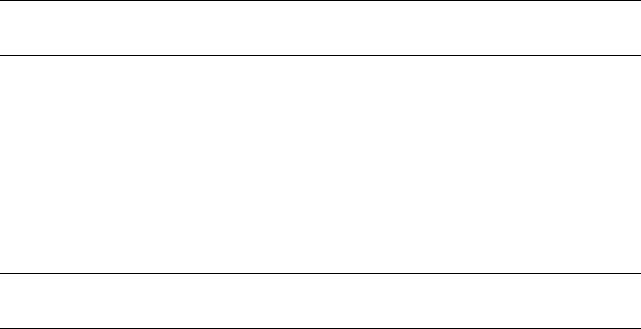
stack need contain only an Editable Spline object and an Edit Patch modifier.
Alternatively, you can use the Edit Spline modifier's Cross Section command.
Generate Surface Creates a patch surface using existing splines to define the
patch edges. Default=on.
Threshold Determines the overall distance that is used to weld the vertices
of the spline object. All vertices/vectors within the threshold distance of each
other are treated as one. Threshold uses units set in the Units Setup dialog
on page 7601 . Default=1.0.
NOTE Spline control handles are also treated as vertices, so setting high Threshold
levels can produce unexpected results.
Flip Normals Reverses the facing direction of the patch surface. Default=off.
Remove Interior Patches Removes interior faces of an object that you would
not normally see. These are the faces created within the caps or other interior
patches of the same type of a closed polygon. Default=on.
Use Only Selected Segs Only segments selected in the Edit Spline modifier
or the editable spline object will be used by the Surface modifier to create
patches. Default=off.
NOTE Segment Sub-Object does not have to be left on in the Edit Spline modifier
or editable spline object.
Edit Poly Modifier
Create or select an object. > Modify panel > Modifier List > Object-Space
Modifiers > Edit Poly
Create or select an object. > Modifiers menu > Mesh Editing > Edit Poly
The Edit Poly modifier provides explicit editing tools for different sub-object
levels of the selected object: vertex, edge, border, polygon, and element. The
Edit Poly modifier includes most capabilities of the base Editable Poly object,
except for Vertex Color information, Subdivision Surface rollout, Weight and
Crease settings, and Subdivision Displacement rollout. Edit Poly lets you
animate sub-object transforms and parameter changes. In addition, because
it's a modifier, you can retain the object creation parameters and change them
later. For detailed information about animating with Edit Poly, see these
procedures on page 1301 .
Edit Poly Modifier | 1293

Edit Poly gives you these options:
■Transform or Shift+Clone the selection, as with any object.
■Use the options on the Edit rollouts to modify the selection or object. Later
topics discuss these options for each of the polymesh components.
■Pass a sub-object selection to a modifier higher in the stack. You can apply
one or more standard modifiers to the selection.
TIP You can exit most Edit Poly command modes, such as Extrude, by right-clicking
in the active viewport.
Overriding Actions with Press/Release Keyboard Shortcuts
While working with Edit Poly objects, you can use a “press/release keyboard
shortcut” to temporarily override the current operation and perform a different
one. As soon as you release the keyboard shortcut, you return to the previous
operation.
For example, you might be working at the Polygon sub-object level, moving
polygons, and need to rotate the object to access a different part of it. Instead
of having to exit the Polygon sub-object level, rotate the object and then
re-enter the sub-object level, you could simply press and hold 6, rotate the
object, release the key, and immediately return to moving polygons.
To see a list of press/release keyboard shortcuts for Edit Poly, go to Customize
> Customize User Interface > Keyboard panel, open the Group drop-down list,
and choose Editable Poly. The actions in boldface are the ones that you can
assign as press/release shortcuts. Not all are assigned; for information about
assigning keyboard shortcuts, see Keyboard Panel on page 7489 .
1294 | Chapter 9 Modifiers
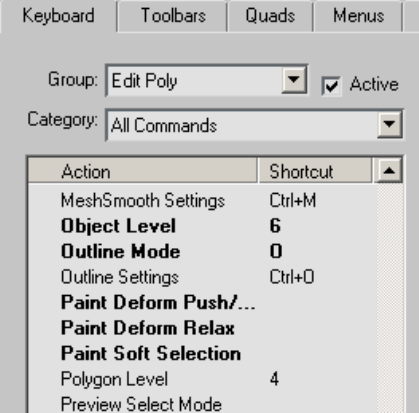
The boldface actions can be assigned as press/release shortcuts.
Differences Between Edit Poly and Editable Poly
Functionality in Edit Poly is mostly the same as that of Editable Poly. Please
note the following differences:
■Edit Poly is a modifier, with all properties that modifier status entails. These
include the ability to place Edit Poly above a base object and other modifiers
on the stack, to move the modifier to different locations in the stack, and
to apply multiple Edit Poly modifiers to the same object, each containing
different modeling or animation operations.
■Edit Poly has two distinct modes of operation: Model and Animate. See
Edit Poly Mode rollout on page 1304 .
■Delete Isolated Vertices is now an option on the Edit Geometry rollout.
Previously, it appeared as a dialog every time you deleted contiguous
polygons. Now you can set it and forget it.
■Edit Poly eliminates the Full Interactivity switch; this feature is on all the
time.
■Edit Poly provides two new ways of obtaining an existing selection from
lower in the stack: Use Stack Selection on page 1312 and Get Stack Selection
on page 1317 .
Edit Poly Modifier | 1295
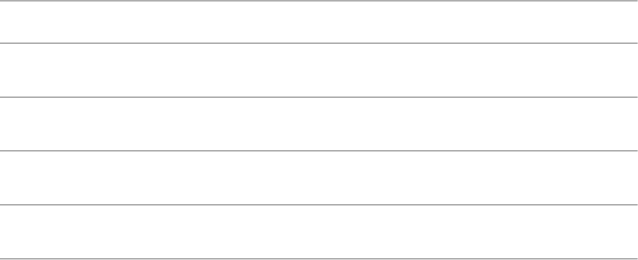
■In addition to the Settings dialogs from Editable Poly, Edit Poly gives you
a new Settings dialog for Align operations, available on the Edit Poly Mode
rollout on page 1304 .
■Edit Poly lacks Editable Poly's Subdivision Surface and Subdivision
Displacement rollouts. There are no Weight or Crease settings for vertices,
edges, or borders. If you need to use Weight and Crease settings, apply a
Meshsmooth modifier on page 1460 , set Iterations to 0, and then make the
settings as desired. Also, there is no provision for setting vertex properties
such as color.
■In Animate mode, you begin a slice operation by clicking Slice, not Slice
Plane. You still need to click Slice Plane to move the plane around. You
can animate the slice plane.
■In some cases, several Undo commands on page 202 might be required to
revert from changes made with certain Edit Poly operations, such as
Extrude.
For example, if you extrude a polygon using the Extrude Polygons dialog
on page 2141 , there will be three Undo actions. The first undoes the Commit,
which happens automatically when you click the dialog OK button at the
end; the second undoes the change in height (from 0 to the height you
set); and the third undoes the entry into the Extrude operation.
Following is a table showing the Edit Poly functions that are and are not
animatable. Functions that are not animatable are unavailable in Animate
mode. Functions marked “Yes” can be animated explicitly in Animate mode.
Functions marked “Proc” cannot be animated explicitly, but can be animated
procedurally. This means they can be applied to different parts of the Edit
Poly object at different points in the animation by means of an animated
sub-object selection passed up the stack. For further information, see this
procedure on page 1302 .
Animatable?Function
YesTransform sub-objects
YesShift+Transform sub-objects
NoConstraints
NoPreserve UVs
1296 | Chapter 9 Modifiers
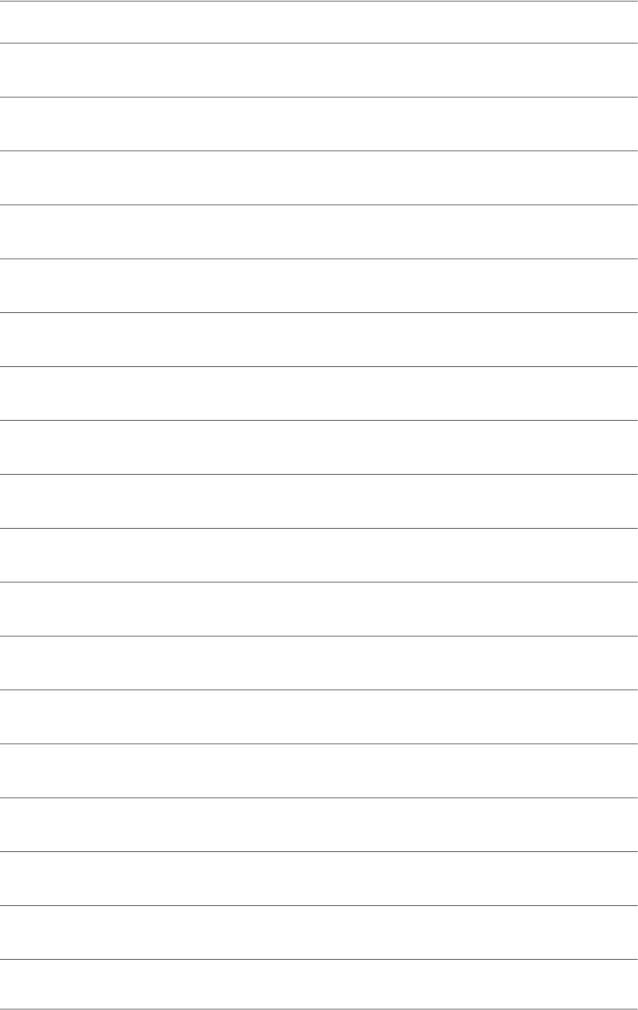
Animatable?Function
NoBy Vertex
NoIgnore Backfacing
NoRing
NoLoop
NoShrink
NoGrow
NoSelection conversion
NoNamed Selection copy/paste
Yes (but not painting soft selection)Soft Selection (most settings)
NoShaded Face toggle
ProcDelete
NoCreate Vertex
NoCreate Face
NoCreate Edge
ProcCollapse
NoAttach / Attach List
NoDetach
YesSlice
Edit Poly Modifier | 1297
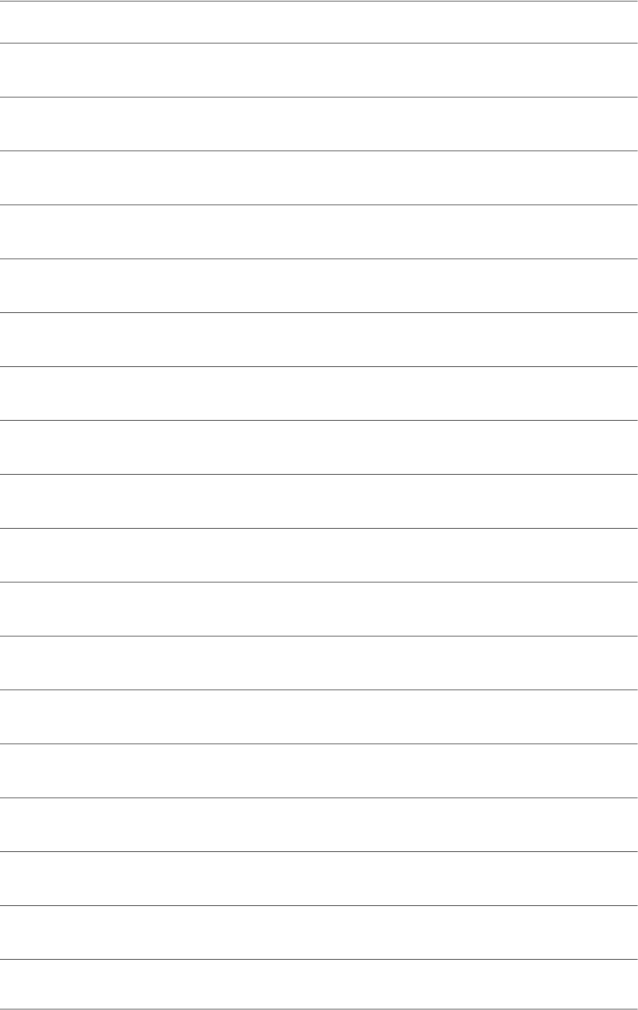
Animatable?Function
NoQuickslice
NoCut
ProcMSmooth
ProcTessellate
ProcMake Planar
YesView Align
YesGrid Align
YesRelax
NoHide Selected
NoHide Unselected
NoUnhide All
ProcRemove
ProcBreak
YesExtrude
YesChamfer
YesBridge
Proc (can animate Weld Threshold)Weld (selected)
NoTarget Weld
1298 | Chapter 9 Modifiers
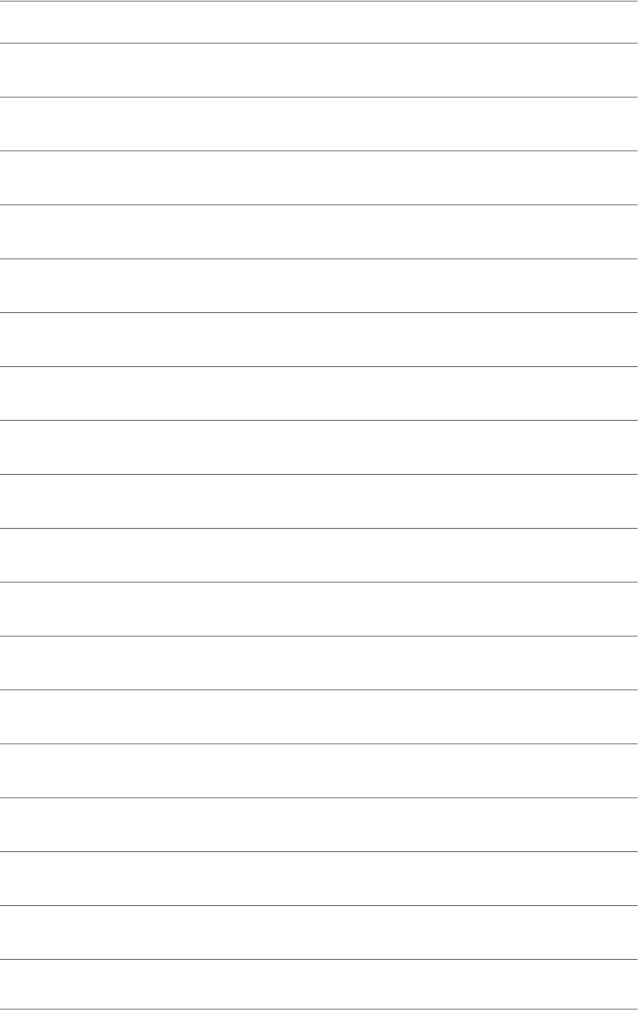
Animatable?Function
YesConnect
ProcRemove Isolated Vertices
ProcRemove Unused Map Verts
YesRemove
YesSplit
NoInsert Vertex
Yes (Threshold)Weld (selected)
NoTarget Weld
ProcConnect (Vertex)
YesConnect (Edge)
NoCreate Shape
NoEdit Triangulation
ProcCap
NoInsert Vertex
YesExtrude
YesBevel
YesOutline
YesInset
Edit Poly Modifier | 1299
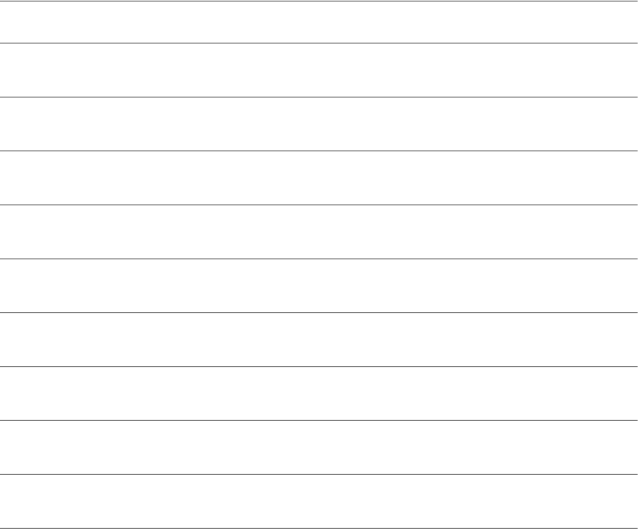
Animatable?Function
ProcRetriangulate
ProcFlip
YesHinge from Edge
YesExtrude Along Spline
YesSet Material ID
NoSelect by Material ID
YesSet Smoothing Group
NoSelect by Smoothing Group
ProcAuto Smooth
Edit Poly Workflow
Edit Poly differs from other Edit modifiers in 3ds Max in that it provides two
different modes, available on the Edit Poly Mode rollout: one for modeling,
and the other for animating. By default, Edit Poly operates in Model mode,
whose functionality is mostly the same as that of Editable Poly. Alternatively,
you can work in Animate mode, where only functions you can animate are
available.
Each Edit Poly modifier can preserve any number of keyframes animating a
single operation type, such as transforming faces, on the same sub-object
selection. To animate other parts of the object, or to animate a different
operation on the same sub-object selection, just use another Edit Poly modifier.
Sub-object-specific functions in the Edit Poly user interface can be found in
their own rollouts, leaving the Edit Geometry rollout with functions that can
be used at most sub-object levels, as well as at the object level.
1300 | Chapter 9 Modifiers
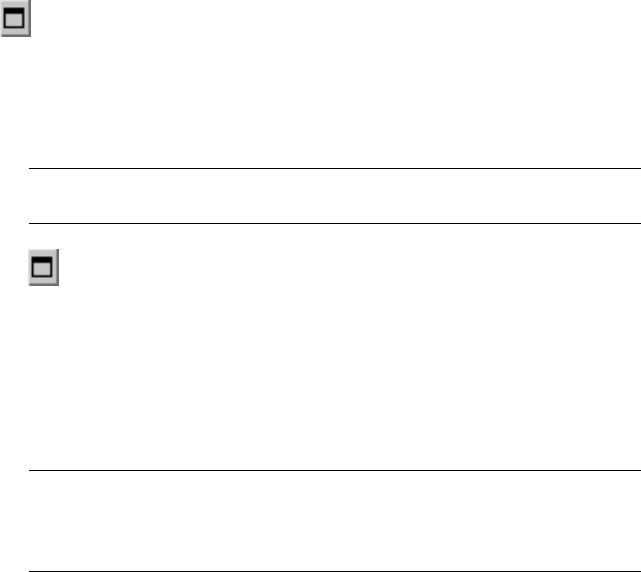
Also, many commands are accompanied by a Settings button, which gives
you two ways of using the command:
■In Direct Manipulation mode, activated by clicking the command button,
you apply the command by manipulating sub-objects directly in the
viewport. An example of this is Extrude.
NOTE Some buttons, such as Tessellate, operate on the mesh immediately,
with no viewport manipulation required.
■ Interactive Manipulation mode is well suited to experimentation. You
activate this mode by clicking the command's Settings button. This opens
a non-modal settings dialog and places you in preview mode, where you
can set parameters and see results immediately in the viewport. You can
then accept the results by clicking OK, or reject them by clicking Cancel.
You can also use this mode to apply the same or different settings to several
different sub-object selections in a row. Make the selection, optionally
change the settings, click Apply, and then repeat with a different selection.
IMPORTANT When you click Apply, the settings are “baked into” the selection,
and then applied again to the selection as a preview. If you then click OK to
exit, you will have applied the settings twice. If your intention is to apply them
only once, simply click OK the first time, or click Apply, and then Cancel.
See also:
■Poly Select Modifier on page 1541
■Turn To Poly Modifier on page 1761
■Editable Poly Surface on page 2038
Procedures
To animate an Edit Poly operation on a sub-object selection:
1Select an object.
2Apply the Edit Poly modifier.
Edit Poly Modifier | 1301
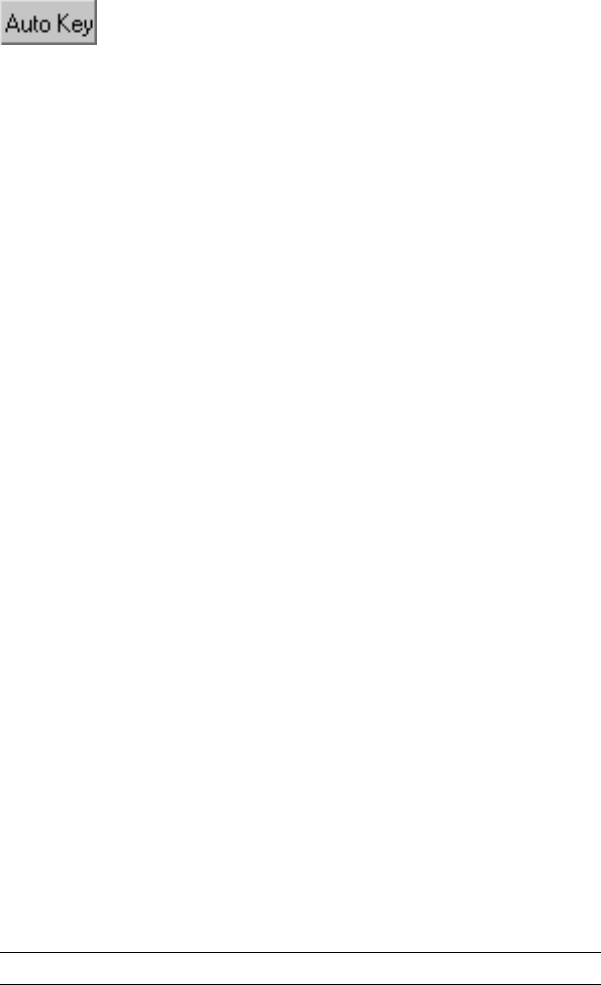
3 Go to the first frame at which to set a key and turn on Auto
Key.
4On the Modify panel > Edit Poly Mode rollout, choose Animate.
5Make a sub-object selection.
6Perform an operation on the selection, such as a transform or extrusion.
7Proceed to the next keyframe and continue to change settings for the
current operation and sub-object selection.
If you change the selection, the existing animation is applied to the new
selection, and lost from the previous one. If you change the operation,
any changes from the previous animation are frozen (that is, “baked”
into the model) at the current frame, and only new keyframes are recorded
in the current Edit Poly modifier.
To animate different sub-object selections using different operations, use
multiple applications of the Edit Poly modifier.
To apply an Edit Poly operation to an animated sub-object selection:
This procedure demonstrates procedural animation with Edit Poly: the ability
to change the location of application on an object during an animation using
an existing, animated sub-object selection.
1Select an object.
2Create an animated sub-object selection. One way to do this is to apply
a Volume Select modifier on page 1910 and animate the gizmo's transform,
or animate the modifier effect by using an animated texture map.
3Apply the Edit Poly modifier.
4Go to the same sub-object level in Edit Poly, and then, on the Selection
rollout, turn on Use Stack Selection.
5Scrub the time slider.
The animated selection appears on the Edit Poly object.
6On the Modify panel > Edit Poly Mode rollout, choose Animate.
7Perform an operation on the sub-object selection, such as a chamfer or
extrusion. You needn't turn on Auto Key or use Set Key.
NOTE With Use Stack Selection on, you can't change the selection.
1302 | Chapter 9 Modifiers
Now, when you play the animation, the Edit Poly effect moves along
with the animation of the sub-object selection.
If you decide to animate a different function procedurally, first click Edit
Poly Mode rollout > Cancel.
Example: To apply an Edit Poly operation procedurally to an animated model:
Edit Poly lets you layer an animated sub-object operation on top of an existing
animation. Try this brief example:
1Create an animated model, such as a box with an animated Bend modifier.
2Apply an Edit Poly modifier, and on the Edit Poly Mode rollout, choose
Animate. Also turn on Auto Key.
3Go to the Polygon sub-object level.
4Go to frame 20 and extrude a polygon.
5Play the animation.
The extrusion animation plays “on top” of the existing animation. This
isn't possible with the Edit Mesh modifier.
Interface
Stack Display
For more information on the stack display, see Modifier Stack on page 7427 .
Show End Result Because Edit Poly is a modifier, if you apply further
modifiers and then return to the Edit Poly stack entry, Show End Result is on
by default, and you can still see the results of any modifiers above Edit Poly
on the stack. This is different from the Editable Poly object, where if you apply
a modifier such as Symmetry on page 1735 and then return to the Editable
Poly stack entry, you cannot see the effect of the modifier on the object's
geometry. While at a sub-object level, if you turn on Show Cage on the Edit
Poly Mode rollout, you can see the final object as a white mesh, the original
sub-object selection as a yellow mesh, and the original Edit Poly object as an
orange mesh.
Edit Poly Modifier | 1303
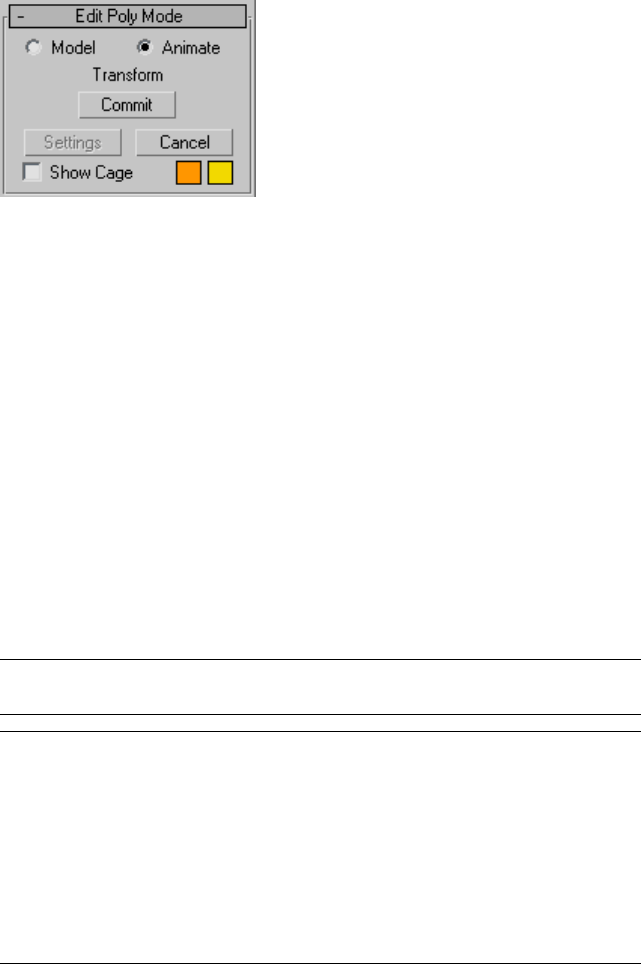
Edit Poly Mode rollout
This rollout provides access to Edit Poly's two modes of operation: Model, for
modeling, and Animate, for animation of modeling effects. For example, you
can animate the Taper and Twist settings for polygons extruded along a spline.
During and between sessions, the software remembers the current mode for
each object separately. The same mode remains active at all sub-object levels.
Edit Poly Mode also gives you access to the current operation's Settings dialog,
if any, and lets you commit to or cancel out of modeling and animation
changes.
Model Lets you model using the Edit Poly functions. Operations in Model
mode cannot be animated.
Animate Lets you animate using the Edit Poly functions.
In addition to choosing Animate, you must turn on Auto Key on page 7344 or
use Set Key on page 7347 for animating sub-object transforms and parameter
changes. Alternatively, in Animate mode you can apply a single command,
such as Extrude or Chamfer, to an animated sub-object selection passed up
the stack.
TIP If you use Set Key to animate with Edit Poly, be sure to turn on Key Filters >
Modifiers.
NOTE The Edit Poly modifier can store any number of keyframes animating a
single operation, such as transforming polygons, on the same sub-object selection.
Use additional Edit Poly modifiers to:
■animate other parts of the object;
■animate repeated applications of the same operation on the same sub-object
selection;
■animate repeated applications of a different operation on the same
sub-object selection.
1304 | Chapter 9 Modifiers
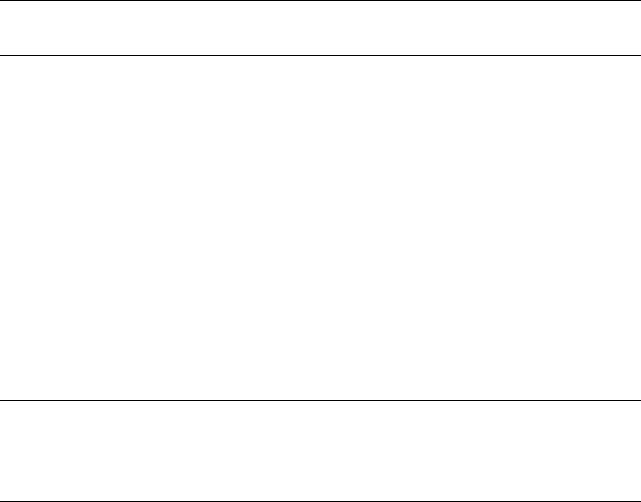
For example, say you want to animate a polygon extruding from an object
from frame 1 to 10, and then moving back to the original position over the
next 10 frames. You can accomplish this with a single Edit Poly modifier using
the Extrude function, setting one keyframe at 10 and another at 20. However,
say you want to animate a polygon extruding outward, and then animate
movement of one of the resultant side polygons. In that case, you'd need two
Edit Poly modifiers: one for the extrusion, and another for the poly transform.
TIP While modeling in Animate mode, you can use Commit on page 1305 to freeze
the animation at the current frame.
[label] Shows the current command, if any. Otherwise, it shows <No Current
Operation>.
When you're working in Model mode using direct manipulation (that is,
working in the viewports), the label shows the current operation during drag
operations, and then returns to the unavailable state.
When you're working in Model mode using a Settings dialog, or in Animate
mode using direct manipulation or a Settings dialog, the label continually
shows the current operation.
Commit In Model mode, using a Settings dialog, accepts any changes and
closes the dialog (same as the OK button on the dialog). In Animate mode,
freezes the animated selection in its state at the current frame and closes the
dialog. Any existing keyframes are lost.
TIP Commit lets you use animation as a modeling aid. For example, you could
animate a vertex selection between two positions, scrub between the two to find
a suitable in-between position, and then use Commit to freeze the model at that
point.
Settings Toggles the Settings dialog for the current command.
Cancel Cancels the most recently used command.
Show Cage Toggles the display of a two-color wireframe that shows the
editable poly object before modification or subdivision. The cage colors are
shown as swatches to the right of the check box. The first color represents
unselected sub-objects, and the second color represents selected sub-objects.
Change a color by clicking its swatch. The Show Cage toggle is available only
at sub-object levels.
Edit Poly Modifier | 1305
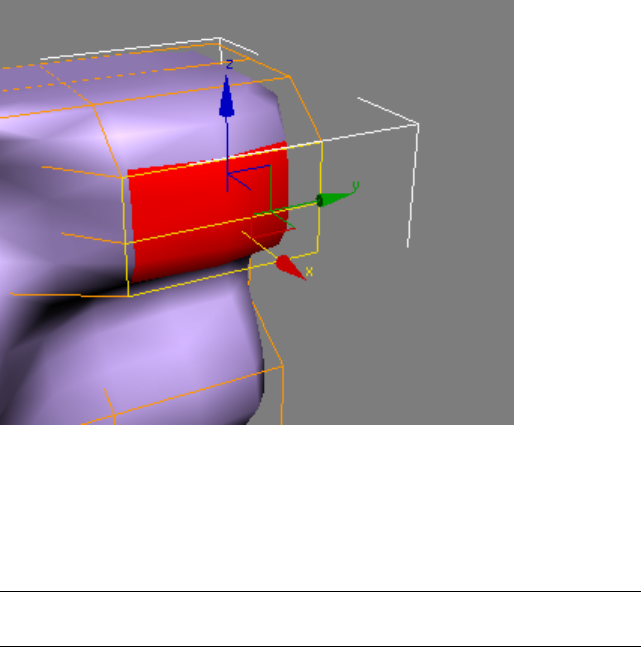
The cage displays the original structure of the edited object.
Typically this feature is used in conjunction with the MeshSmooth modifier
on page 1460 because it lets you easily toggle visibility of the unsmoothed base
object while simultaneously viewing the smoothed result, but it works with
any modifier.
TIP Show Cage is also particularly helpful when used with the Symmetry modifier
on page 1735 .
Selection rollout
The Selection rollout provides tools for accessing different sub-object levels
and display settings and for creating and modifying selections. See Selection
Rollout (Edit Poly Modifier) on page 1307 .
Soft Selection rollout
Soft Selection controls apply a smooth falloff between selected sub-objects
and unselected ones. When Use Soft Selection is on, unselected sub-objects
near your selection are given partial selection values. These values are shown
in the viewports by means of a color gradient on the vertices, and optionally
on the faces. They affect most types of sub-object deformations, such as the
Move, Rotate, and Scale functions and any deformation modifiers (such as
1306 | Chapter 9 Modifiers
Bend) applied to the object. This provides a magnet-like effect with a sphere
of influence around the selection.
For more information, see Soft Selection Rollout on page 1926 .
Edit (sub-object) rollout
The Edit (sub-object) rollout provides sub-object-specific functions for editing
an Edit Poly object and its sub-objects. For specific information, click any of
the following links:
Edit Vertices rollout on page 1323
Edit Edges rollout on page 1333
Edit Borders rollout on page 1345
Edit Polygons/Elements rollout on page 1351
Edit Geometry rollout
The Edit Geometry rollout on page 1363 provides global functions for editing
an Edit Poly object and its sub-objects. For information specific to a sub-object
level, click one of the following links:
Edit Poly (Object) on page 1319
Edit Poly (Vertex) on page 1321
Edit Poly (Edge) on page 1330
Edit Poly (Border) on page 1343
Edit Poly (Polygon/Element) on page 1350
Paint Deformation rollout
Paint Deformation lets you stroke elevated and indented areas directly onto
object surfaces. For more information, see Paint Deformation Rollout on page
2125 .
Selection Rollout (Edit Poly Modifier)
Select an Edit Poly object. > Modify panel > Selection rollout
Edit Poly Modifier | 1307
The Selection rollout provides tools for accessing different sub-object levels
and display settings and for creating and modifying selections. It also displays
information about selected entities.
When you first access the Modify panel with an Edit Poly object selected,
you're at the Object level, with several functions available as described in Edit
Poly (Object) on page 1319 . You can toggle the various sub-object levels and
access relevant functions by clicking the buttons at the top of the Selection
rollout.
Clicking a button here is the same as choosing a sub-object type in the modifier
stack display. Click the button again to turn it off and return to the Object
selection level.
1308 | Chapter 9 Modifiers
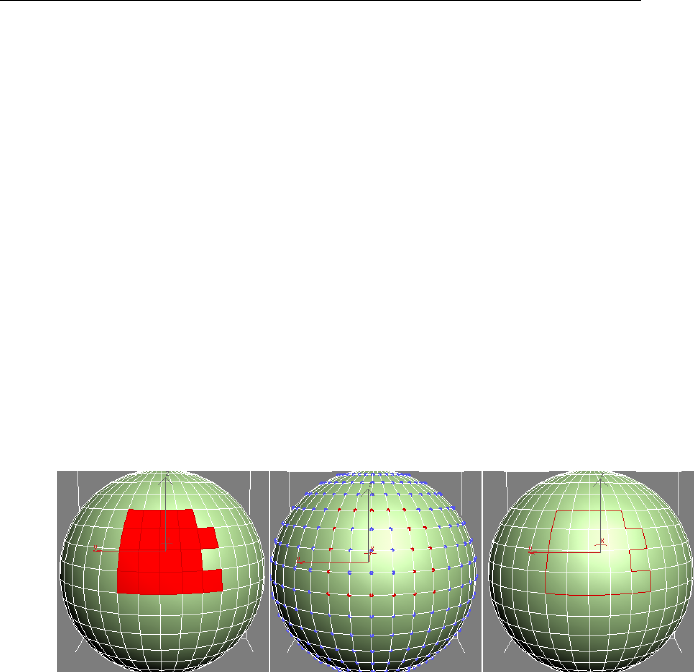
NOTE You can convert sub-object selections in three different ways with the use
of the Ctrl and Shift keys:
■Clicking a sub-object button in the Selection rollout with Ctrl held down
converts the current selection to the new level, selecting all sub-objects in
the new level that touch the previous selection. For example, if you select
a vertex, and then Ctrl+click the Polygon button, all polygons using that
vertex are selected.
■To convert the selection to only sub-objects all of whose source components
are originally selected, hold down both Ctrl and Shift as you change the
level. For example, if you convert a vertex selection to a polygon selection
with Ctrl+Shift+click, the resultant selection includes only those polygons
all of whose vertices were originally selected.
■To convert the selection to only sub-objects that border the selection, hold
down Shift as you change the level. The selection conversion is inclusive,
meaning:
■When you convert faces, the resulting selection of edges or vertices all
belong to selected faces that bordered unselected faces. Only the edges
or vertices that bordered unselected faces are selected.
Face selection (left) converted to vertex border (center) and edge border (right)
■When you convert vertices to faces, the resulting selection of faces had
all of their vertices selected and bordered unselected faces. When you
convert vertices to edges, the resulting selection contains only edges
all of whose vertices were previously selected and only edges of faces
that did not have all vertices selected; that is, of faces around the border
of the vertex selection.
Edit Poly Modifier | 1309
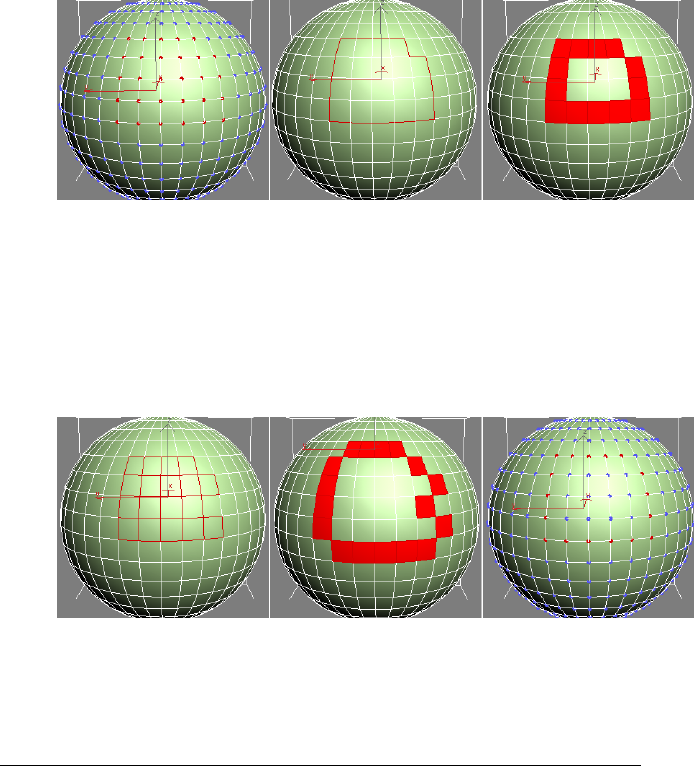
Vertex selection (left) converted to edge border (center) and face border (right)
■When you convert edges to faces, the resulting selection of faces had
some but not all of their edges selected, and were next to faces with no
edges selected. When you convert edges to vertices, the resulting vertices
are on previously selected edges, but only at intersections where not
all edges were selected.
Edge selection (left) converted to face border (center) and vertex border (right)
Conversion commands are also available from the quad menu.
1310 | Chapter 9 Modifiers
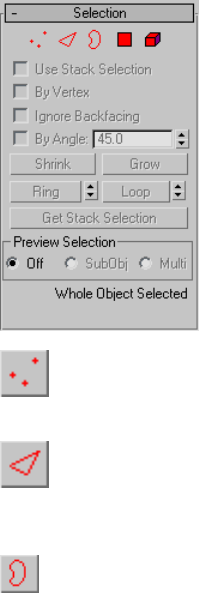
Interface
Vertex Accesses the Vertex sub-object level, which lets you select a
vertex beneath the cursor; region selection selects vertices within the region.
Edge Accesses the Edge sub-object level, which lets you select a polygon
edge beneath the cursor; region selection selects multiple edges within the
region.
Border Accesses the Border sub-object level, which lets you select a
sequence of edges that borders a hole in the mesh. A border is always composed
of edges with faces on only one side of them, and is always a complete loop.
For example, a box doesn't normally have a border, but the Teapot object has
several of them: on the lid, on the body, on the spout, and two on the handle.
If you create a cylinder and then delete one end, the row of edges around that
end forms a circular border.
When Border sub-object level is active, you can't select edges that aren't on
borders. Clicking a single edge on a border selects the whole border.
You can cap a border, either in Edit Poly or by applying the Cap Holes modifier
on page 1159 . You can also connect borders between objects with the Connect
compound object on page 668 .
The Edge and Border sub-object levels are compatible, so if you go from one
to the other, any existing selection is retained.
Edit Poly Modifier | 1311
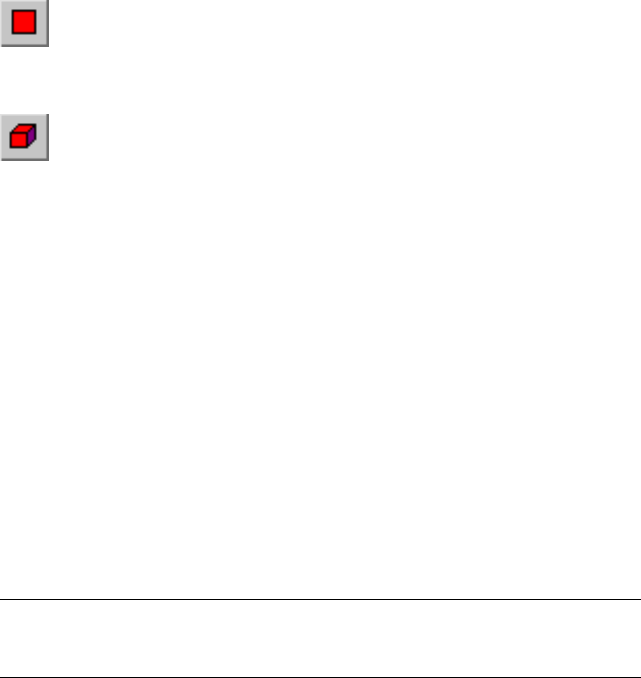
Polygon Accesses the Polygon sub-object level, which lets you select
polygons beneath the cursor. Region selection selects multiple polygons within
the region.
Element Turns on Element sub-object level, which lets you select all
contiguous polygons in an object. Region selection lets you select multiple
elements.
The Polygon and Element sub-object levels are compatible, so if you go from
one to the other, any existing selection is retained.
Use Stack Selection When on, Edit Poly automatically uses any existing
sub-object selection passed up the stack, and prevents you from manually
changing the selection.
By Vertex When on, you can select a sub-object only by selecting a vertex
that it uses. When you click a vertex, all sub-objects that use the selected
vertex are selected.
Ignore Backfacing When on, selection of sub-objects affects only those facing
you. When off (the default), you can select any sub-object(s) under the mouse
cursor, regardless of visibility or facing. If multiple sub-objects lie under the
cursor, repeated clicking cycles through them. Likewise, with Ignore Backfacing
off, region selection includes all sub-objects, regardless of the direction they
face.
NOTE The state of the Backface Cull setting in the Display panel does not affect
sub-object selection. Thus, if Ignore Backfacing is off, you can still select sub-objects,
even if you can't see them.
By Angle When on, if you select a polygon, the software also selects
neighboring polygons based on the angle setting to the right of the check
box. This value determines the maximum angle between neighboring polygons
that will be selected. Available only at the Polygon sub-object level.
For example, if you click a side of a box and the angle value is less than 90.0,
only that side is selected, because all sides are at 90-degree angles to each
other. But if the angle value is 90.0 or greater, all sides of the box are selected.
This function speeds up selection of contiguous areas made up of polygons
at similar angles to one another. You can select coplanar polygons with a
single click at any angle value.
1312 | Chapter 9 Modifiers
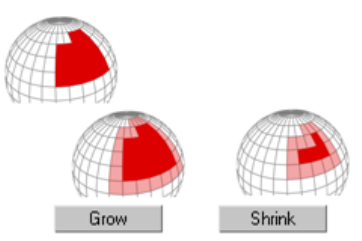
Shrink Reduces the sub-object selection area by unselecting the outermost
sub-objects. If the selection size can no longer be reduced, the remaining
sub-objects are unselected.
Grow Expands the selection area outward in all available directions.
For this function, a border is considered to be an edge selection.
With Shrink and Grow, you can add or remove neighboring elements from the edges
of your current selection. This works at any sub-object level.
Ring Expands an edge selection by selecting all edges parallel to the selected
edges. Ring applies only to edge and border selections.
Edit Poly Modifier | 1313
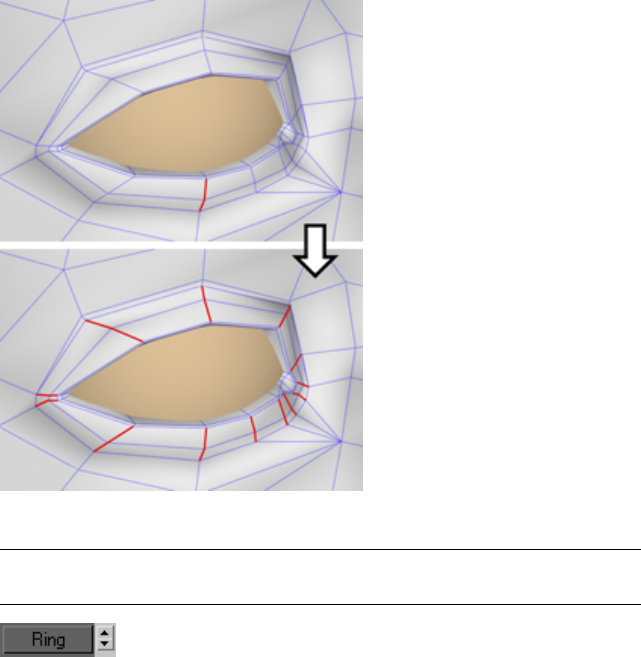
Ring selection adds to the selection all the edges parallel to the ones selected originally.
TIP After making a ring selection, you can use Connect on page 2080 to subdivide
the associated polygons into new edge loops.
[Ring Shift] The spinner next to the Ring button lets you move
the selection in either direction to other edges in the same ring; that is, to
neighboring, parallel edges. If you have a loop selected, you can use this
function to select a neighboring loop. Applies only to Edge and Border
sub-object levels.
1314 | Chapter 9 Modifiers
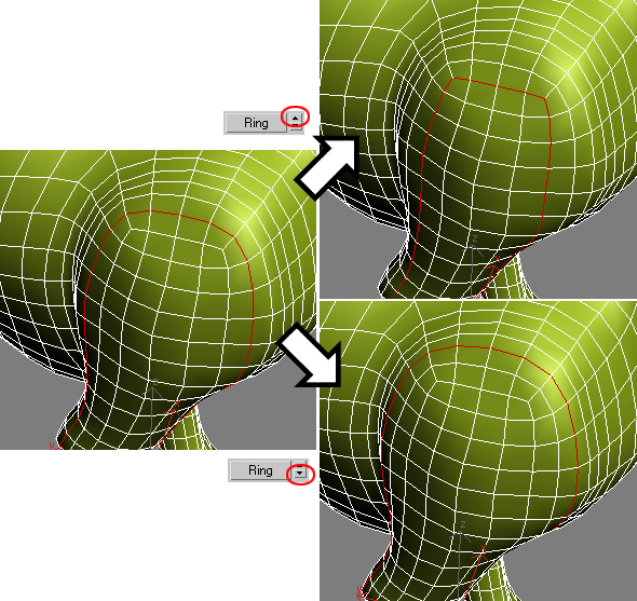
Left: Original loop selection
Upper right: Ring Shift up moves selection outward (from center of model).
Lower right: Ring Shift down moves selection inward (toward center of model).
To expand the selection in the chosen direction, Ctrl+click the up or down
spinner button. To shrink the selection in the chosen direction, Alt+click the
up or down spinner button.
Loop Expands the selection as far as possible, in alignment with selected
edges.
Loop applies only to edge and border selections, and propagates only through
four-way junctions.
Edit Poly Modifier | 1315
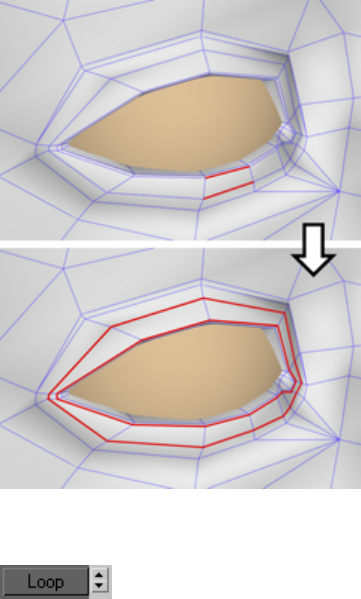
Loop selection extends your current edge selection by adding all edges aligned to the
ones selected originally.
[Loop Shift] The spinner next to the Loop button lets you
move the selection in either direction to other edges in the same loop; that
is, to neighboring, aligned edges. If you have a ring selected, you can use this
function to select a neighboring ring. Applies only to Edge and Border
sub-object levels.
1316 | Chapter 9 Modifiers
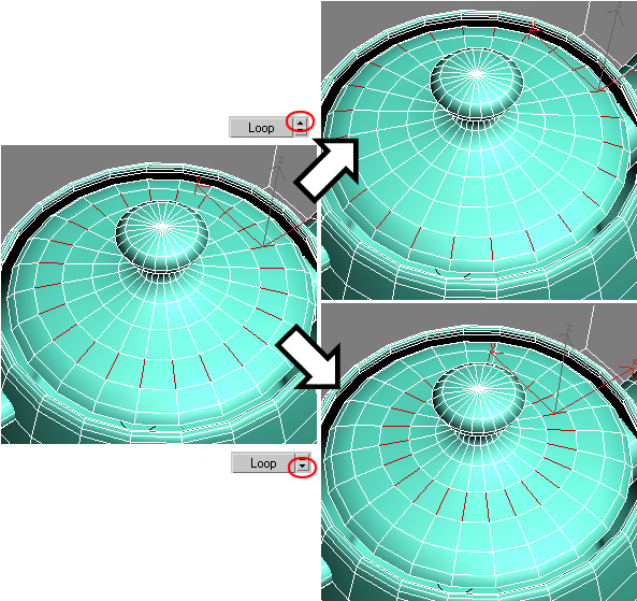
Left: Original ring selection
Upper right: Loop Shift up moves selection outward.
Lower right: Loop Shift down moves selection inward.
To expand the selection in the chosen direction, Ctrl+click the up or down
spinner button. To shrink the selection in the chosen direction, Alt+click the
up or down spinner button.
Get Stack Selection Replaces the current selection with the sub-object
selection passed up the stack. You can then modify this selection using
standard methods.
If no selection exists in the stack, all sub-objects are unselected.
Edit Poly Modifier | 1317
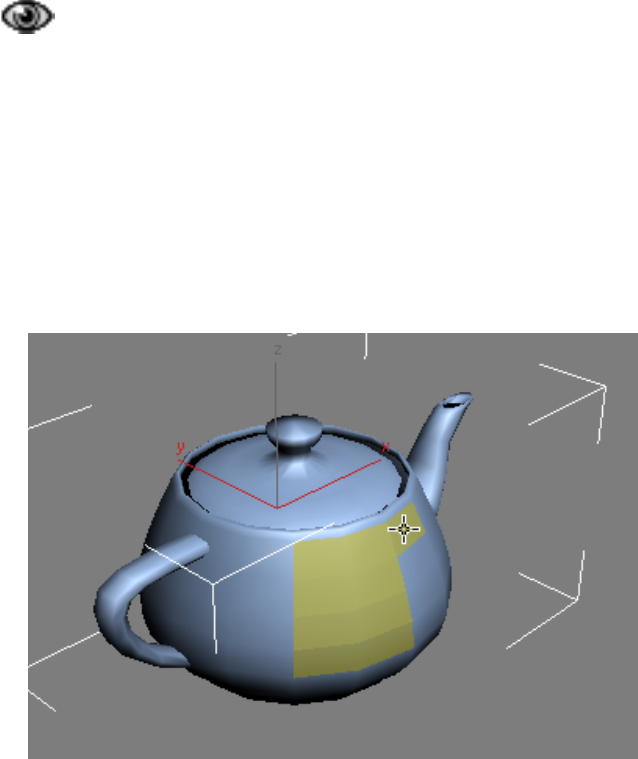
Preview Selection
This option lets you preview a sub-object selection before committing to it.
You can preview at the current sub-object level, or switch sub-object levels
automatically based on the mouse position. The choices are:
■Off No preview is available.
■SubObj Enables previewing at the current sub-object level only. As you
move the mouse over the object, the sub-object under the cursor highlights
in yellow. To select the highlighted object, click the mouse.
To select multiple sub-objects at the current level, press and hold Ctrl,
move the mouse to highlight more sub-objects, and then click to select all
highlighted sub-objects.
Polygon sub-object selection preview with Ctrl held down
To deselect multiple sub-objects at the current level, press and hold Ctrl+Alt,
move the mouse to highlight more sub-objects, and then click a selected
sub-object. This deselects all highlighted sub-objects.
■Multi Works like SubObj, but also switches among the Vertex, Edge, and
Polygon sub-object levels on the fly, based on the mouse position. For
example, if you position the mouse over an edge, the edge highlights, and
then clicking activates the Edge sub-object level and selects the edge.
1318 | Chapter 9 Modifiers
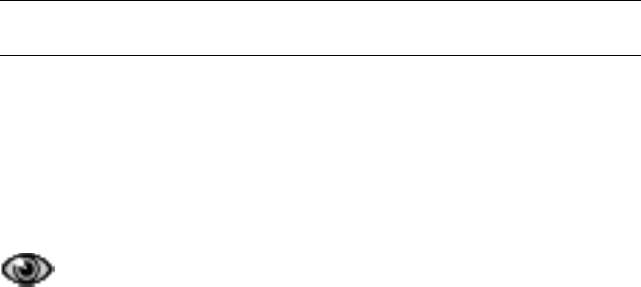
To select multiple sub-objects of the same type, press and hold Ctrl after
highlighting a sub-object, move the mouse to highlight more sub-objects,
and then click to activate that sub-object level and select all highlighted
sub-objects.
To deselect multiple sub-objects at the current sub-object level, press and hold
Ctrl+Alt, move the mouse to highlight more sub-objects, and then click a
selected sub-object. This deselects all highlighted sub-objects. Note that
this method does not switch sub-object levels.
NOTE When Ignore Backfacing is off, you’ll see backfacing vertices and edges
highlight while previewing a sub-object selection.
Selection Information
At the bottom of the Selection rollout is a text display giving information
about the current selection. If 0 or more than one sub-object is selected, the
text gives the number and type selected; for example, “4 Polygons Selected.”
If one sub-object is selected, the text gives the identification number and type
of the selected item; for example, “Polygon 73 Selected.”
When using Preview Selection on page 1318 , a second line gives
additional information about the identity or number of highlighted
sub-objects.
Edit Poly (Object)
Select an Edit Poly object. > Modify panel
Edit Poly (Object) functions are available when no sub-object levels are active.
These functions are also available at all sub-object levels, and work the same
in each mode, except as noted below.
Edit Poly Modifier | 1319
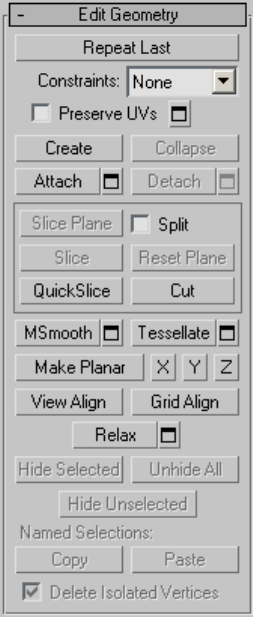
Interface
Edit Geometry rollout
See Edit Geometry Rollout (Edit Poly Modifier) on page 1363 for detailed
descriptions of these controls.
Paint Deformation rollout
Paint Deformation lets you stroke elevated and indented areas directly onto
object surfaces. For more information, see Paint Deformation Rollout on page
2125 .
1320 | Chapter 9 Modifiers

Edit Poly (Vertex)
Select an Edit Poly object. > Modify panel > Selection rollout > Vertex
Select an Edit Poly object. > Modify panel > Modify Stack display > Expand
Edit Poly. > Vertex
Select an Edit Poly object. > Quad menu > Tools 1 quadrant > Vertex
Vertices are points in space: They define the structure of other sub-objects
that make up the poly object. When vertices are moved or edited, the geometry
they form is affected as well. Vertices can also exist independently; such
isolated vertices can be used to construct other geometry but are otherwise
invisible when rendering.
At the Edit Poly (Vertex) sub-object level, you can select single and multiple
vertices and move them using standard methods. This topic covers the Edit
Vertices and Edit Geometry rollouts; for other controls, see Edit Poly Modifier
on page 1293 .
Procedures
To weld polygon vertices:
You can use either of two methods to combine several vertices into one, also
known as welding. If the vertices are very close together, use the Weld function.
You can also use Weld to combine a number of vertices to the average position
of all of them.
Alternatively, to combine two vertices that are far apart, resulting in a single
vertex that's in the same position as one of them, use Target Weld.
1To use Weld:
■On the Selection rollout, turn on Ignore Backfacing, if necessary. This
ensures that you're welding only vertices you can see.
■Select the vertices to weld.
■If the vertices are very close together, simply click Weld. If that doesn't
work, proceed to the next step.
■ Click the Settings button to the right of the Weld button.
Edit Poly Modifier | 1321
This opens the Weld Vertices dialog on page 2150 .
■Increase the Weld Threshold value gradually using the spinner (click
and hold on the up-down arrow buttons to the right of the numeric
field and then drag upward). If you need the value to change more
quickly, hold down the Ctrl key as you drag.
When the threshold equals or exceeds the distance between two or
more of the vertices, the weld occurs automatically, and the resulting
vertex moves to their average location.
■If not all the vertices are welded, continue increasing the Weld
Threshold value until they are.
■Click OK to exit.
2To use Target Weld:
1On the Selection rollout, turn on Ignore Backfacing, if necessary.
This ensures that you're welding only vertices you can see.
2Find two vertices you want to weld, and determine the ultimate
location of the resulting vertex. The two vertices must be contiguous;
that is, they must be connected by a single edge.
For this example, we'll call the vertices A and B, and the resulting
vertex will be at vertex B's location.
3Click the Target Weld button.
The button stays highlighted, to indicate that you're now in Target
Weld mode.
4Click vertex A and then move the mouse.
A rubber-band line connects the vertex and the mouse cursor.
5Position the cursor over vertex B, whereupon the cursor image
changes from an arrow to a crosshairs. Reminder: Only vertices
connected to the first vertex by a single edge qualify for target
welding.
6Click to weld the two.
The resulting vertex remains at vertex B's position, and you exit
Target Weld mode.
1322 | Chapter 9 Modifiers
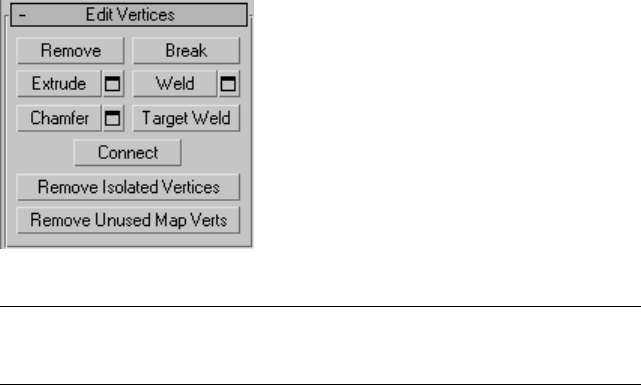
Interface
Edit Poly Mode rollout
See Edit Poly Mode rollout on page 1304 for information on the Edit Poly Mode
rollout settings.
Selection rollout
See Selection rollout on page 1306 for information on the Selection rollout
settings.
Soft Selection rollout
Soft Selection controls apply a smooth falloff between selected sub-objects
and unselected ones. When Use Soft Selection is on, unselected sub-objects
near your selection are given partial selection values. These values are shown
in the viewports by means of a color gradient on the vertices, and optionally
on the faces. They affect most types of sub-object deformations, such as the
Move, Rotate, and Scale functions, as well as any deformation modifiers (such
as Bend) applied to the object. This provides a magnet-like effect with a sphere
of influence around the selection.
For more information, see Soft Selection Rollout on page 1926 .
Edit Vertices rollout
This rollout includes commands specific to vertex editing.
NOTE To delete vertices, select them and press the Delete key. This can create
one or more holes in the mesh. To delete vertices without creating holes, use
Remove (see following entry).
Edit Poly Modifier | 1323
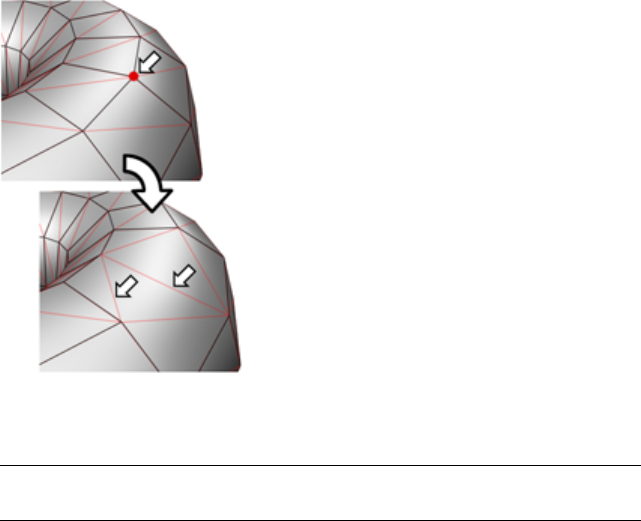
Remove Deletes selected vertices and combines the polygons that use them.
The keyboard shortcut is Backspace.
Removing one or more vertices deletes them and retriangulates the mesh to keep the
surface intact. If you use the Delete key instead, the polygons depending on those
vertices are deleted as well, creating a hole in the mesh.
WARNING Use of Remove can result in mesh shape changes and non-planar
polygons.
Break Creates a new vertex for each polygon attached to selected vertices.
This allows the polygon corners to move away from each other where they
were once joined at each original vertex. If a vertex is isolated or used by only
one polygon, it is unaffected.
Extrude Lets you extrude vertices manually via direct manipulation in the
viewport. Click this button, and then drag vertically on any vertex to extrude
it.
Extruding a vertex moves it along a normal and creates new polygons that
form the sides of the extrusion, connecting the vertex to the object. The
extrusion has the same number of sides as the number of polygons that
originally used the extruded vertex.
Important aspects of vertex extrusion are:
■The mouse cursor changes to an Extrude cursor when over a selected vertex.
1324 | Chapter 9 Modifiers
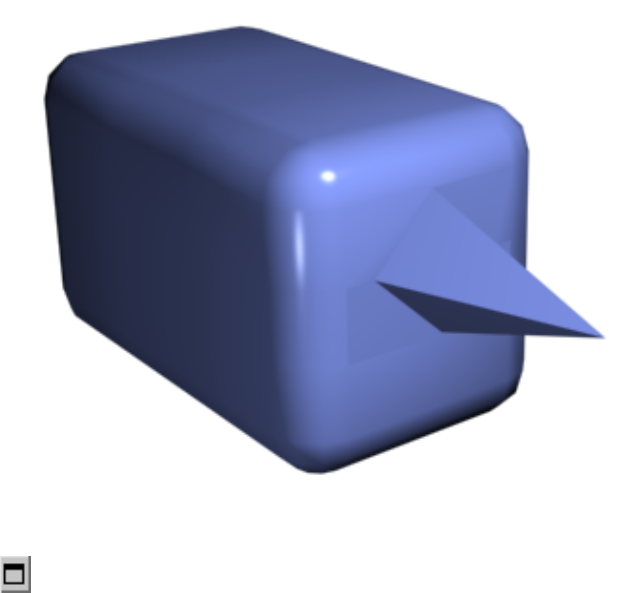
■Drag vertically to specify the extent of the extrusion, and horizontally to
set the size of the base.
■With multiple vertices selected, dragging on any one extrudes all selected
vertices equally.
■You can drag other vertices in turn to extrude them while the Extrude
button is active. Click Extrude again or right-click in the active viewport
to end the operation.
Chamfer box showing extruded vertex
Extrude Settings Opens the Extrude Vertices dialog on page 2142 , which
lets you perform extrusion via interactive manipulation.
If you click this button after performing a manual extrusion, the same extrusion
is performed on the current selection as a preview and the dialog opens with
Extrusion Height set to the amount of the last manual extrusion.
Weld Combines contiguous, selected vertices that fall within the tolerance
specified in the Weld dialog on page 2150 . All edges become connected to the
resulting single vertex.
Edit Poly Modifier | 1325

Weld is best suited to automatically simplify geometry that has areas with
several vertices in close proximity.
Weld Settings Opens the Weld dialog on page 2150 , which lets you
specify the weld threshold.
Chamfer Click this button and then drag vertices in the active object. To
chamfer vertices numerically, click the Chamfer Settings button and adjust
the Chamfer Amount value.
If you chamfer multiple selected vertices, all of them are chamfered identically.
If you drag an unselected vertex, any selected vertices are first unselected.
Each chamfered vertex is effectively replaced by a new face that connects new
points on all edges leading to the original vertex. These new points are exactly
<chamfer amount> distance from the original vertex along each of these edges.
New chamfer faces are created with the material ID of one of the neighboring
faces (picked at random) and a smoothing group that is an intersection of all
neighboring smoothing groups.
For example, if you chamfer one corner of a box, the single corner vertex is
replaced by a triangular face whose vertices move along the three edges that
led to the corner. Outside faces are rearranged and split to use these three new
vertices, and a triangle is created at the corner.
Alternatively, you can create open space around the chamfered vertices;
for details, see Chamfer Vertices dialog on page 2136 .
1326 | Chapter 9 Modifiers
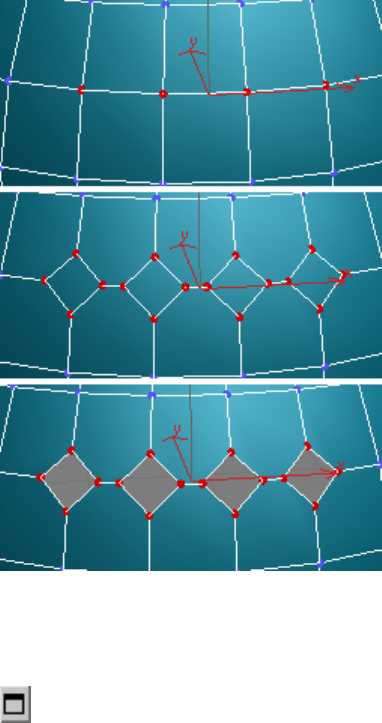
Top: The original vertex selection
Center: Vertices chamfered
Bottom: Vertices chamfered with Open on
Chamfer Settings Opens the Chamfer Vertices dialog on page 2136 , which
lets you chamfer vertices via interactive manipulation and toggle the Open
option.
If you click this button after performing a manual chamfer, the same chamfer
is performed on the current selection as a preview and the dialog opens with
Chamfer Amount set to the amount of the last manual chamfer.
Target Weld Lets you select a vertex and weld it to a target vertex. When
positioned over a vertex, the cursor changes to a + cursor. Click and move the
mouse and a dashed line appears from the vertex with an arrow cursor at the
other end of the line. Position the cursor over a neighboring vertex and when
the + cursor appears again, click the mouse. The first vertex moves to the
position of the second, and the two are welded.
Edit Poly Modifier | 1327
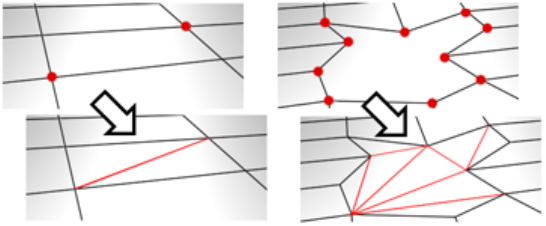
Connect Creates new edges between pairs of selected vertices.
Connect will not let the new edges cross. For example, if you select all four
vertices of a four-sided polygon and then click Connect, only two of the
vertices will connect. In this case, to connect all four vertices with new edges,
use Cut on page 2113 .
Remove Isolated Vertices Deletes all vertices that don't belong to any
polygons.
Remove Unused Map Verts Certain modeling operations can leave unused
(isolated) map vertices that show up in the Unwrap UVW editor on page 1788
, but cannot be used for mapping. You can use this button to delete these map
vertices automatically.
1328 | Chapter 9 Modifiers
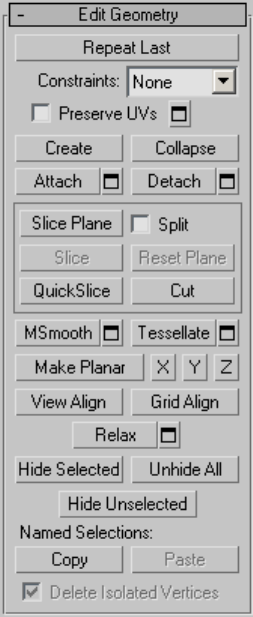
Edit Geometry rollout
See Edit Geometry Rollout (Edit Poly Modifier) on page 1363 for detailed
descriptions of these controls.
Paint Deformation rollout
Paint Deformation lets you stroke elevated and indented areas directly onto
object surfaces. For more information, see Paint Deformation Rollout on page
2125 .
Edit Poly Modifier | 1329

Edit Poly (Edge)
Select an Edit Poly object. > Modify panel > Selection rollout > Edge
Select an Edit Poly object. > Modify panel > Modifier Stack display > Expand
Edit Poly. > Edge
Select an Edit Poly object. > Quad menu > Tools 1 quadrant > Edge
An edge is a line connecting two vertices that forms the side of a polygon. An
edge can't be shared by more than two polygons. Also, the normals of the two
polygons should be adjacent. If they aren't, you wind up with two edges that
share vertices.
At the Edit Poly Edge sub-object level, you can select single and multiple edges
and transform them using standard methods. This topic covers the Edit
Geometry and Edit Edges rollouts; for other controls, see Edit Poly Modifier
on page 1293 .
Procedures
To create a shape from one or more edges:
1Select the edges you want to make into shapes.
2On the Edit Edges rollout, click the Create Shape button. This creates the
shape immediately, using default settings. Alternatively, click the Settings
button next to Create Shape.
3Make changes, as needed, on the Create Shape dialog that appears.
■Enter a curve name or keep the default.
■Choose Smooth or Linear as the shape type.
4Click OK.
The resulting shape consists of one or more splines whose vertices are
coincident with the vertices in the selected edges. The Smooth option
results in rounded-corner Bezier vertices, while the Linear option results
in straight-line splines with Corner vertices.
If the selected edges are not continuous, or if they branch, the resulting
shape will consist of more than one spline. When the Create Shape
function runs into a branching 'Y' in the edges, it makes an arbitrary
decision about which edge produces which spline. If you need to control
this, select only edges that will result in a single spline, and perform a
1330 | Chapter 9 Modifiers
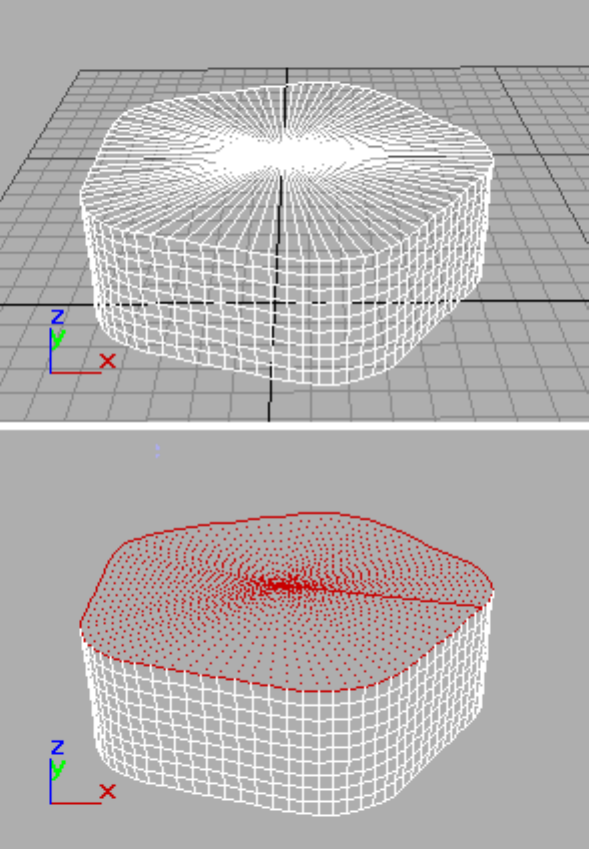
Create Shape operation repeatedly to make the correct number of shapes.
Finally, use Attach on page 627 in the Editable Spline to combine the
shapes into one.
Above: Original object
Edit Poly Modifier | 1331
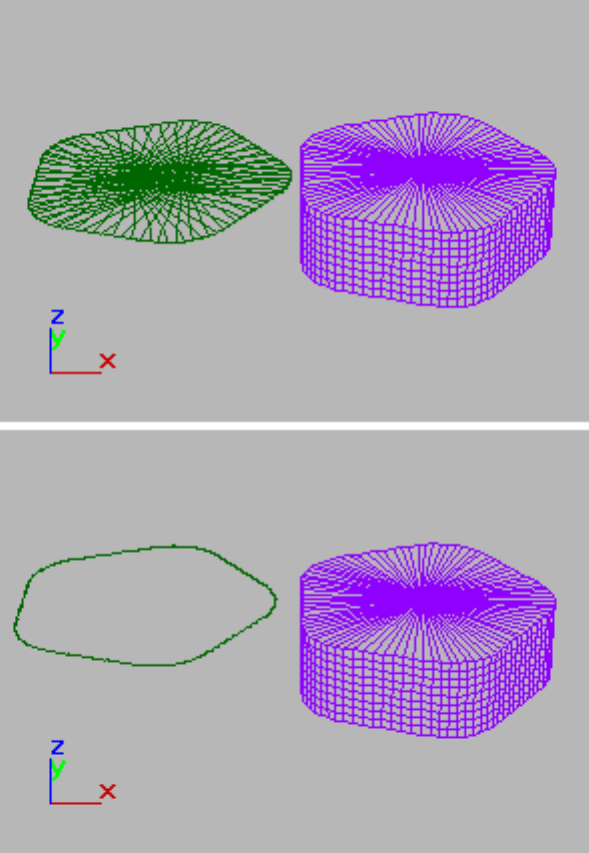
Below: Object with edges selected
Above: Selected edges removed from original object
Below: Unwanted edges removed
1332 | Chapter 9 Modifiers
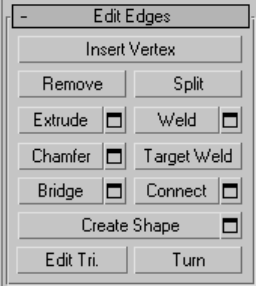
Interface
Edit Poly Mode rollout
See Edit Poly Mode rollout on page 1304 for information on the Edit Poly Mode
rollout settings.
Selection rollout
See Selection rollout on page 1306 for information on the Selection rollout
settings.
Soft Selection rollout
Soft Selection controls apply a smooth falloff between selected sub-objects
and unselected ones. When Use Soft Selection is on, unselected sub-objects
near your selection are given partial selection values. These values are shown
in the viewports by means of a color gradient on the vertices, and optionally
on the faces. They affect most types of sub-object deformations, such as the
Move, Rotate, and Scale functions, as well as any deformation modifiers (such
as Bend) applied to the object. This provides a magnet-like effect with a sphere
of influence around the selection.
For more information, see Soft Selection Rollout on page 1926 .
Edit Edges rollout
This rollout includes commands specific to edge editing.
Edit Poly Modifier | 1333
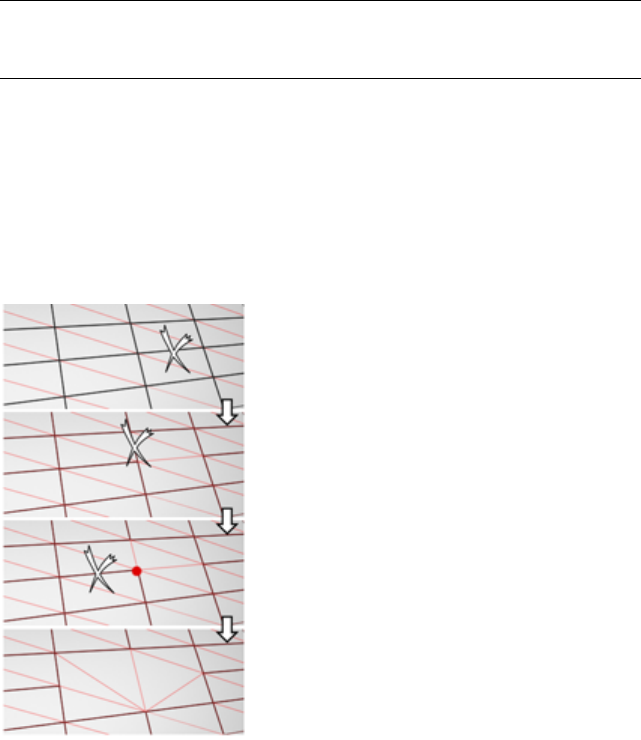
NOTE To delete edges, select them and press the Delete key. This deletes all
selected edges and attached polygons, which can create one or more holes in the
mesh. To delete edges without creating holes, use Remove (see following entry).
Insert Vertex Lets you subdivide visible edges manually.
After turning on Insert Vertex, click an edge to add a vertex at that location.
You can continue subdividing polygons as long as the command is active.
To stop inserting edges, right-click in the viewport, or click Insert Vertex again
to turn it off.
Remove Deletes selected edges and combines the polygons that use them.
The keyboard shortcut is Backspace.
Removing one edge is like making it invisible. The mesh is affected only when you
remove all but one of the edges depending on one vertex. At that point, the vertex
itself is deleted and the surface is retriangulated.
To delete the associated vertices as well, press and hold Ctrl while executing
a Remove operation, either by mouse or with the Backspace key. This option,
called Clean Remove, ensures that the remaining polygons are planar.
1334 | Chapter 9 Modifiers
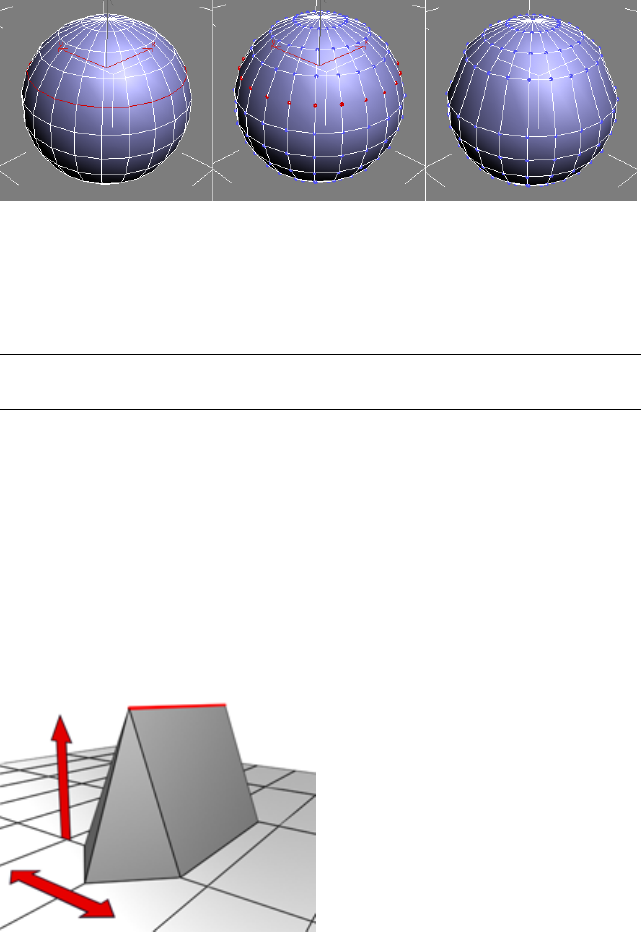
Left: The original edge selection
Center: Standard Remove operation leaves extra vertices.
Right: Clean Remove with Ctrl+Remove deletes the extra vertices.
Edges with the same polygon on both sides usually can't be removed.
WARNING Use of Remove can result in mesh shape changes and non-planar
polygons.
Split Divides the mesh along the selected edges.
Split does nothing when applied to a single edge in the middle of a mesh. The
vertices at the end of affected edges must be separable for this option to work.
For example, it would work on a single edge that intersects an existing border,
since the border vertex can be split in two. Additionally, two adjacent edges
could be split in the middle of a grid or sphere, since the shared vertex can
be split.
Extrude Lets you extrude edges manually via direct manipulation in the
viewport. Click this button, and then drag vertically on any edge to extrude
it.
When extruding a vertex or edge interactively in the viewport, you set the extrusion
height by moving the mouse vertically and the base width by moving the mouse
horizontally.
Edit Poly Modifier | 1335
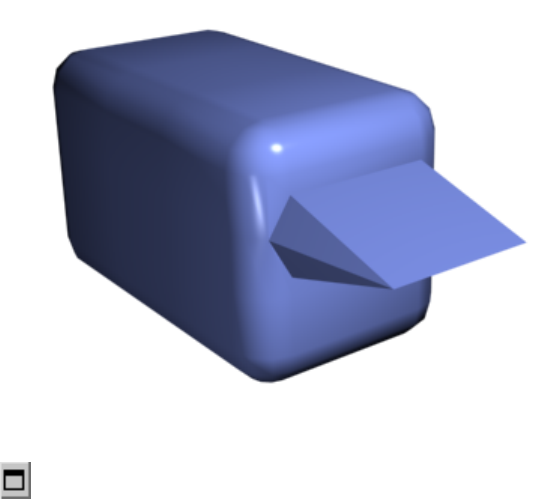
Extruding an edge moves it along a normal and creates new polygons that
form the sides of the extrusion, connecting the edge to the object. The
extrusion has either three or four sides; three if the edge was on a border, or
four if it was shared by two polygons. As you increase the length of the
extrusion, the base increases in size, to the extent of the vertices adjacent to
the extruded edge's endpoints.
Important aspects of edge extrusion are:
■The mouse cursor changes to an Extrude cursor when over a selected edge.
■Drag vertically to specify the extent of the extrusion, and horizontally to
set the size of the base.
■With multiple edges selected, dragging on any one extrudes all selected
edges equally.
■You can drag other edges in turn to extrude them while the Extrude button
is active. Click Extrude again or right-click in the active viewport to end
the operation.
Chamfer box showing extruded edge
Extrude Settings Opens the Extrude Edges dialog on page 2142 , which
lets you perform extrusion via interactive manipulation.
1336 | Chapter 9 Modifiers

If you click this button after performing a manual extrusion, the same extrusion
is performed on the current selection as a preview and the dialog opens with
Extrusion Height set to the amount of the last manual extrusion.
Weld Combines selected edges that fall within the threshold specified in
the Weld dialog on page 2150 .
You can weld only edges that have one polygon attached; that is, edges on a
border. Also, you cannot perform a weld operation that results in illegal
geometry, such as an edge shared by more than two polygons. For example,
you cannot weld opposite edges on the border of a box that has a side removed.
Weld Settings Opens the Weld dialog on page 2150 , which lets you specify
the weld threshold.
Chamfer Click this button and then drag edges in the active object. To
chamfer vertices numerically, click the Chamfer Settings button and change
the Chamfer Amount value.
If you chamfer multiple selected edges, all of them are chamfered identically.
If you drag an unselected edge, the software first deselects any selected edges.
An edge chamfer "chops off" the selected edges, creating a new polygon
connecting new points on all visible edges leading to the original vertex. The
new edges are exactly <chamfer amount> distance from the original edge
along each of these edges. New chamfer faces are created with the material
ID of a neighboring face (picked at random) and a smoothing group that is
an intersection of all neighboring smoothing groups.
For example, if you chamfer one edge of a box, each corner vertex is replaced
by two vertices moving along the visible edges that lead to the corner. Outside
faces are rearranged and split to use these new vertices, and a new polygon is
created at the corner.
Alternatively, you can create open space around the chamfered edges; for
details, see Chamfer Edges dialog on page 2136 .
Chamfer Settings Opens the Chamfer Edges dialog on page 2136 , which
lets you chamfer edges via interactive manipulation and toggle the Open
option.
If you click this button after performing a manual chamfer, the same chamfer
is performed on the current selection as a preview and the dialog opens with
Chamfer Amount set to the amount of the last manual chamfer.
Target Weld Allows you to select an edge and weld it to a target edge. When
positioned over an edge, the cursor changes to a + cursor. Click and move the
mouse and a dashed line appears from the vertex with an arrow cursor at the
Edit Poly Modifier | 1337

other end of the line. Position the cursor over another edge and when the +
cursor appears again, click the mouse. The first edge is moved to the position
of the second, and the two are welded.
You can weld only edges that have one polygon attached; that is, edges on a
border. Also, you cannot perform a weld operation that results in illegal
geometry, such as an edge shared by more than two polygons. For example,
you cannot weld opposite edges on the border of a box that has a side removed.
Bridge Connects border edges on an object with a polygon “bridge.” Bridge
connects only border edges; that is, edges that have a polygon on only one
side. This tool is particularly useful when creating edge loops or profiles.
There are two ways to use Bridge in Direct Manipulation mode (that is, without
opening the Bridge Edges settings dialog):
■Select two or more border edges on the object, and then click Bridge. This
immediately creates the bridge between the pair of selected borders using
the current Bridge settings, and then deactivates the Bridge button.
■If no qualifying selection exists (that is, two or more selected border edges),
clicking Bridge activates the button and places you in Bridge mode. First
click a border edge and then move the mouse; a rubber-band line connects
the mouse cursor to the clicked edge. Click a second edge on a different
border to bridge the two. This creates the bridge immediately using the
current Bridge settings; the Bridge button remains active for connecting
more edges. To exit Bridge mode, right-click the active viewport or click
the Bridge button.
NOTE Bridge always creates a straight-line connection between edges. To make
the bridge connection follow a contour, apply modeling tools as appropriate after
creating the bridge. For example, bridge two edges, and then use Bend on page
1139 .
Bridge Settings Opens the Bridge Edges dialog on page 2133 , which lets
you add polygons between pairs of edges via interactive manipulation.
Connect Creates new edges between pairs of selected edges using the current
Connect Edges dialog settings. Connect is particularly useful for creating or
refining edge loops.
1338 | Chapter 9 Modifiers
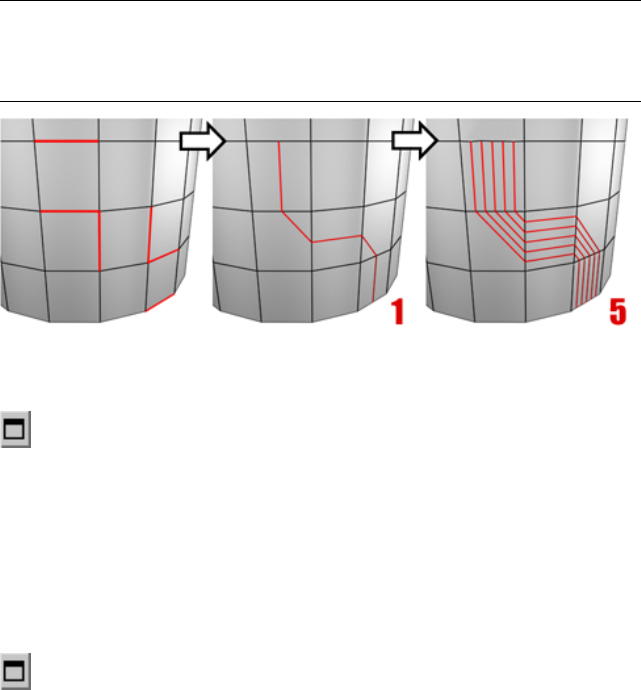
NOTE You can connect only edges on the same polygon. Also, Connect will not
let the new edges cross. For example, if you select all four edges of a four-sided
polygon and then click Connect, only neighboring edges are connected, resulting
in a diamond pattern.
Connecting two or more edges creates equally spaced edges. The number of edges is
set in the dialog.
Connect Settings Opens the Connect Edges dialog on page 2137 , which
lets you preview the Connect results, specify the number of edge segments
created by the operation, and set spacing and placement for the new edges.
Create Shape After selecting one or more edges, click this button to create
a spline shape or shapes from the selected edges, using the current settings
from the Create Shape Settings dialog (see following).
The new shape's pivot is placed at the same location as that of the Edit Poly
object.
Create Shape Settings Lets you preview the Create Shape function, name
the shape, and set it to Smooth or Linear.
Edit Poly Modifier | 1339
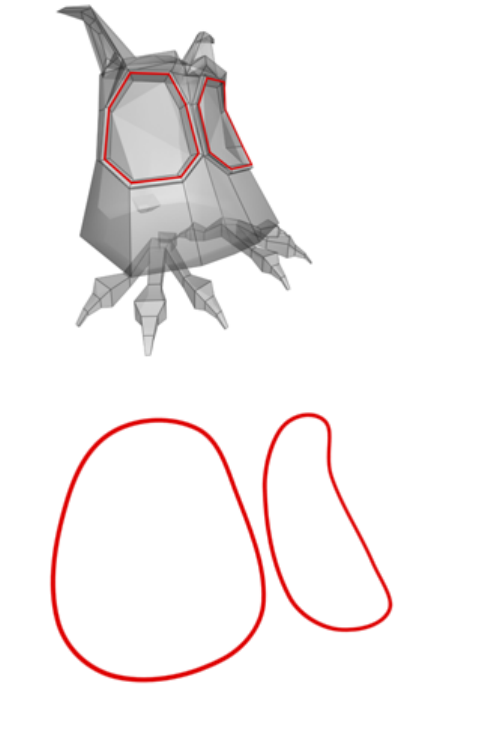
1340 | Chapter 9 Modifiers
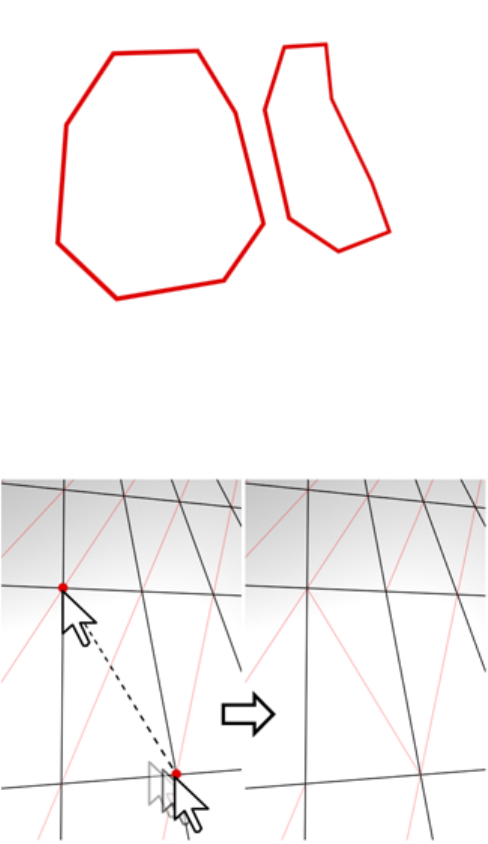
An edge selection (top); a smooth shape (center); a linear shape (bottom)
Edit Tri[angulation] Lets you modify how polygons are subdivided into
triangles by drawing diagonals.
In Edit Triangulation mode, you can see the current triangulation in the viewport, and
change it by clicking two vertices on the same polygon.
To edit triangulation manually, turn on this button. The diagonals appear.
Click a polygon vertex. A rubber-band line appears, attached to the cursor.
Click a non-adjacent vertex to create a new triangulation for the polygon.
Edit Poly Modifier | 1341

TIP For easier editing of triangulation, use the Turn command instead (see
following).
Turn Lets you modify how polygons are subdivided into triangles by clicking
diagonals. When you activate Turn, the diagonals on page 7757 become visible
as dashed lines in wireframe and edged-faces views. In Turn mode, click a
diagonal to change its position. To exit Turn mode, right-click in the viewport
or click the Turn button again.
Each diagonal has only two available positions at any given time, so clicking
a diagonal twice in succession simply returns it to its original position. But
changing the position of a nearby diagonal can make a different alternate
position available to a diagonal.
For more information on how to use Turn with the enhanced Cut tool, see
this procedure on page ? .
1342 | Chapter 9 Modifiers

Edit Geometry rollout
See Edit Geometry Rollout (Edit Poly Modifier) on page 1363 for detailed
descriptions of these controls.
Paint Deformation rollout
Paint Deformation lets you stroke elevated and indented areas directly onto
object surfaces. For more information, see Paint Deformation Rollout on page
2125 .
Edit Poly (Border)
Select an Edit Poly object. > Modify panel > Selection rollout > Border
Edit Poly Modifier | 1343
Select an Edit Poly object. > Modify panel > Modifier Stack display > Expand
Edit Poly. > Border
Select an Edit Poly object. > Quad menu > Tools 1 quadrant > Border
A border is a linear section of a mesh that can generally be described as the
edge of a hole. This is usually a sequence of edges with polygons on only one
side. For example, a box doesn't have a border, but the teapot object has
several: on the lid, on the body, on the spout, and two on the handle. If you
create a cylinder, and then delete an end polygon, the adjacent row of edges
forms a border.
At the Edit Poly Border sub-object level, you can select single and multiple
borders and transform them using standard methods. This topic covers the
Edit Geometry and Edit Borders rollouts; for other controls, see Edit Poly
Modifier on page 1293 .
Procedures
To create a polygon that closes the surface at the selected border:
1At the Border sub-object level, select any open edge.
This selects the entire closed loop of continuous open edges that make
up the border selection.
2Click Edit Borders rollout > Cap.
Interface
Edit Poly Mode rollout
See Edit Poly Mode rollout on page 1304 for information on the Edit Poly Mode
rollout settings.
Selection rollout
See Selection rollout on page 1306 for information on the Selection rollout
settings.
Soft Selection rollout
Soft Selection controls apply a smooth falloff between selected sub-objects
and unselected ones. When Use Soft Selection is on, unselected sub-objects
near your selection are given partial selection values. These values are shown
in the viewports by means of a color gradient on the vertices, and optionally
1344 | Chapter 9 Modifiers
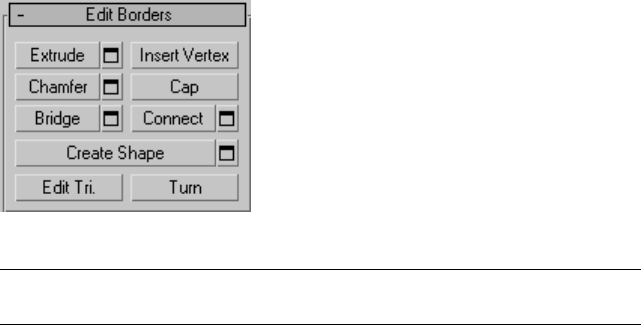
on the faces. They affect most types of sub-object deformations, such as the
Move, Rotate, and Scale functions, as well as any deformation modifiers (such
as Bend) applied to the object. This provides a magnet-like effect with a sphere
of influence around the selection.
For more information, see Soft Selection Rollout on page 1926 .
Edit Borders rollout
This rollout includes commands specific to editing borders.
NOTE To delete a border, select it and press the Delete key. This deletes the border
and all attached polygons.
Extrude Lets you extrude a border manually via direct manipulation in the
viewport. Click this button, and then drag vertically on any border to extrude
it.
Extruding a border moves it along a normal and creates new polygons that
form the sides of the extrusion, connecting the border to the object. The
extrusion can form a varying number of additional sides, depending on the
geometry near the border. As you increase the length of the extrusion, the
base increases in size, to the extent of the vertices adjacent to the extruded
border's endpoints.
Important aspects of border extrusion are:
■The mouse cursor changes to an Extrude cursor when over a selected border.
■Drag vertically to specify the extent of the extrusion, and horizontally to
set the size of the base.
■With multiple borders selected, dragging on any one extrudes all selected
borders equally.
Edit Poly Modifier | 1345
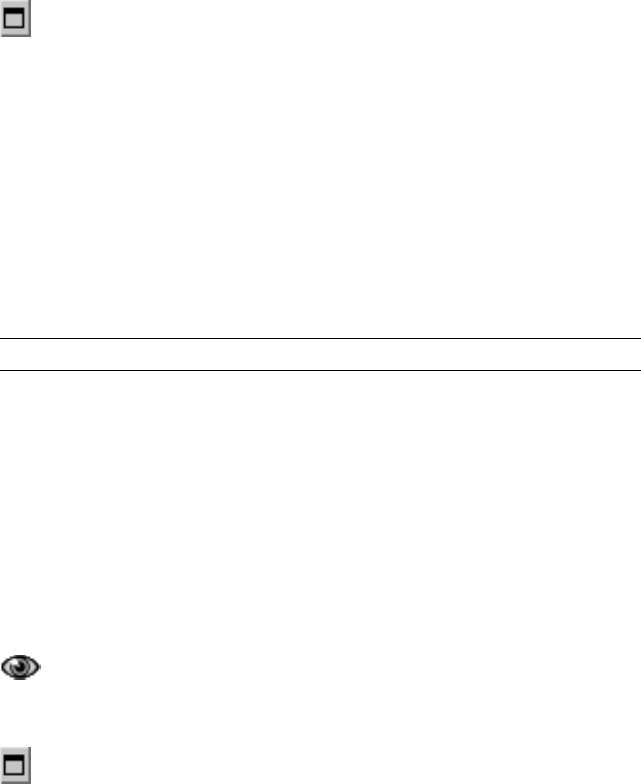
■You can drag other borders in turn to extrude them while the Extrude
button is active. Click Extrude again or right-click in the active viewport
to end the operation.
Extrude Settings Opens the Extrude Edges dialog on page 2142 , which
lets you perform extrusion via interactive manipulation.
If you click this button after performing a manual extrusion, the same extrusion
is performed on the current selection as a preview and the dialog opens with
Extrusion Height set to the amount of the last manual extrusion.
Insert Vertex Lets you subdivide border edges manually.
After turning on Insert Vertex, click a border edge to add a vertex at that
location. You can continue subdividing border edges as long as the command
is active.
To stop inserting vertices, right-click in the viewport, or click Insert Vertex
again to turn it off.
NOTE In previous versions of the software, this command was called Divide.
Chamfer Click this button and then drag a border in the active object. The
border need not be selected first.
If you chamfer multiple selected borders, all of them are chamfered identically.
If you drag an unselected border, any selected borders are first unselected.
A border chamfer essentially “frames” the border edges, creating a new set of
edges paralleling the border edges, plus new diagonal edges at any corners.
These new edges are exactly <Chamfer Amount> distance from the original
edges. New chamfer faces are created with the material ID of a neighboring
face (picked at random) and a smoothing group which is an intersection of
all neighboring smoothing groups.
Alternatively, you can create open space around the chamfered borders,
essentially cutting away at the open edges; for details, see Chamfer Edges
dialog on page 2136 .
Chamfer Settings Opens the Chamfer Edges dialog on page 2136 , which
lets you chamfer borders via interactive manipulation and toggle the Open
option.
1346 | Chapter 9 Modifiers
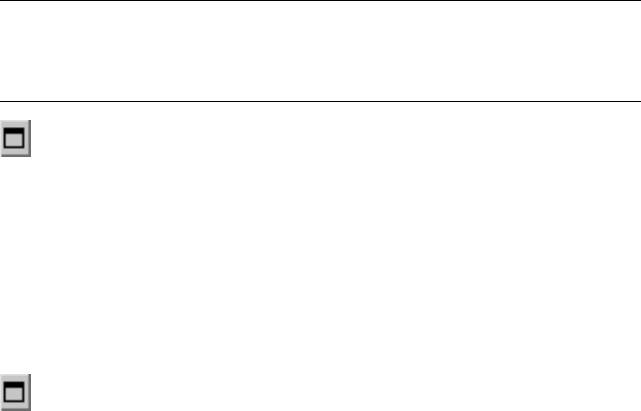
If you click this button after performing a manual chamfer, the same chamfer
is performed on the current selection as a preview and the dialog opens with
Chamfer Amount set to the amount of the last manual chamfer.
Cap Caps an entire border loop with a single polygon.
Select the border, and then click Cap.
Bridge Connects two borders on an object with a polygon “bridge.” There
are two ways to use Bridge in Direct Manipulation mode (that is, without
opening the Bridge Settings dialog):
■Select an even number of borders on the object, and then click Bridge.
This immediately creates the bridge between each pair of selected borders
using the current Bridge settings, and then deactivates the Bridge button.
■If no qualifying selection exists (that is, two or more selected borders),
clicking Bridge activates the button and places you in Bridge mode. First
click a border edge and then move the mouse; a rubber-band line connects
the mouse cursor to the clicked edge. Click a second edge on a different
border to bridge the two. This creates the bridge immediately using the
current Bridge settings; the Bridge button remains active for connecting
more pairs of borders. To exit Bridge mode, right-click the active viewport
or click the Bridge button.
NOTE Bridge always creates a straight-line connection between border pairs. To
make the bridge connection follow a contour, apply modeling tools as appropriate
after creating the bridge. For example, bridge two borders, and then use Bend
on page 1139 .
Bridge Settings Opens the Bridge dialog on page 2131 , which lets you
connect pairs of borders via interactive manipulation.
Connect Creates new edges between pairs of selected border edges. The edges
are connected from their midpoints.
You can connect only edges on the same polygon.
Connect will not let the new edges cross. Thus, for example, if you select all
four edges of a four-sided polygon and then click Connect, only neighboring
edges are connected, resulting in a diamond pattern.
Connect Settings Lets you preview the Connect and specify the number
of edge segments created by the operation. To increase the mesh resolution
around the new edge, increase the Connect Edge Segments setting.
Edit Poly Modifier | 1347
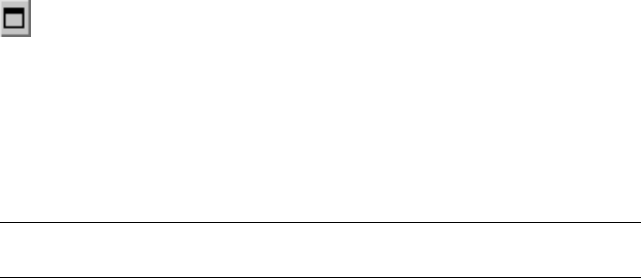
Create Shape After selecting one or more borders, click this button to create
a spline shape or shapes from the selected edges, using the current settings
from the Create Shape Settings dialog (see following).
The new shape's pivot is placed at the same location as that of the Edit Poly
object.
Create Shape Settings Lets you preview the Create Shape function, name
the shape, and set it to Smooth or Linear.
Edit Tri[angulation] Lets you modify how selected polygons are subdivided
into triangles by drawing internal edges.
To manually edit triangulation, turn on this button. The hidden edges appear.
Click a polygon vertex. A rubber-band line appears, attached to the cursor.
Click a non-adjacent vertex to create a new triangulation for the polygon.
TIP For easier editing of triangulation, use the Turn command instead (see
following).
Turn Lets you modify how polygons are subdivided into triangles by clicking
diagonals. When you activate Turn, the diagonals on page 7757 become visible
as dashed lines in wireframe and edged-faces views. In Turn mode, click a
diagonal to change its position. To exit Turn mode, right-click in the viewport
or click the Turn button again.
Each diagonal has only two available positions at any given time, so clicking
a diagonal twice in succession simply returns it to its original position. But
changing the position of a nearby diagonal can make a different alternate
position available to a diagonal.
For more information on how to use Turn with the enhanced Cut tool, see
this procedure on page ? .
1348 | Chapter 9 Modifiers
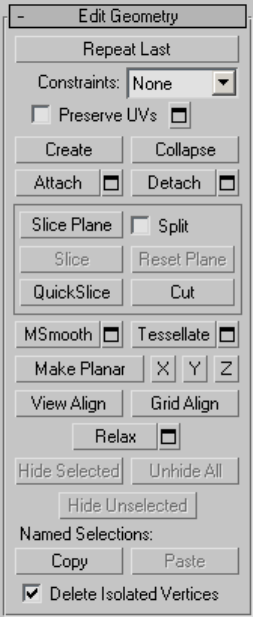
Edit Geometry rollout
See Edit Geometry Rollout (Edit Poly Modifier) on page 1363 for detailed
descriptions of these controls.
Paint Deformation rollout
Paint Deformation lets you stroke elevated and indented areas directly onto
object surfaces. For more information, see Paint Deformation Rollout on page
2125 .
Edit Poly Modifier | 1349
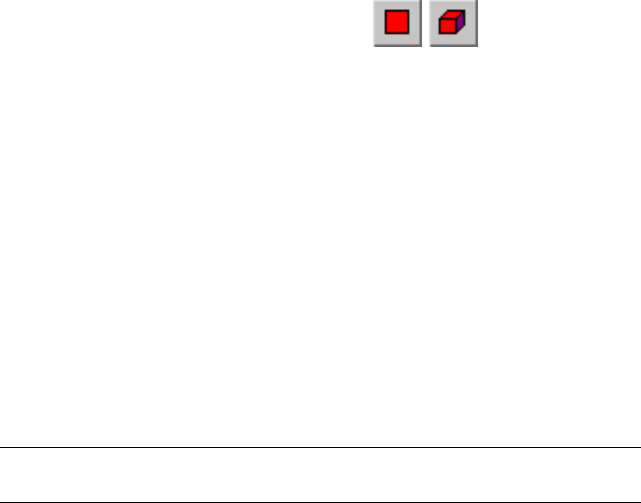
Edit Poly (Polygon/Element)
Select an Edit Poly object. > Modify panel > Selection rollout >
Polygon/Element
Select an Edit Poly object. > Modify panel > modifier stack display > Expand
Edit Poly. > Polygon/Element
Select an Edit Poly object. > Quad menu > Tools 1 quadrant > Polygon/Element
A polygon is a closed sequence of three or more edges connected by a surface.
Polygons provide the renderable surface of Edit Poly objects.
At the Edit Poly (Polygon) sub-object level, you can select single and multiple
polygons and transform them using standard methods. This is similar for the
Element sub-object level; for the distinctions between polygon and element,
see Edit Poly > Selection rollout on page 1306 . This topic covers the Edit
Polygons/Elements rollout and Edit Geometry rollout functions for these
sub-object types. For other controls, see Edit Poly Modifier on page 1293 .
NOTE Workflow enhancements in the Edit Poly user interface give you a choice
of editing methods. See Edit Poly Workflow on page 1300 for more information.
Interface
Edit Poly Mode rollout
See Edit Poly Mode rollout on page 1304 for information on the Edit Poly Mode
rollout settings.
Selection rollout
See Selection rollout on page 1306 for information on the Selection rollout
settings.
Soft Selection rollout
Soft Selection controls apply a smooth falloff between selected sub-objects
and unselected ones. When Use Soft Selection is on, unselected sub-objects
near your selection are given partial selection values. These values are shown
in the viewports by means of a color gradient on the vertices, and optionally
on the faces. They affect most types of sub-object deformations, such as the
Move, Rotate, and Scale functions, as well as any deformation modifiers (such
1350 | Chapter 9 Modifiers
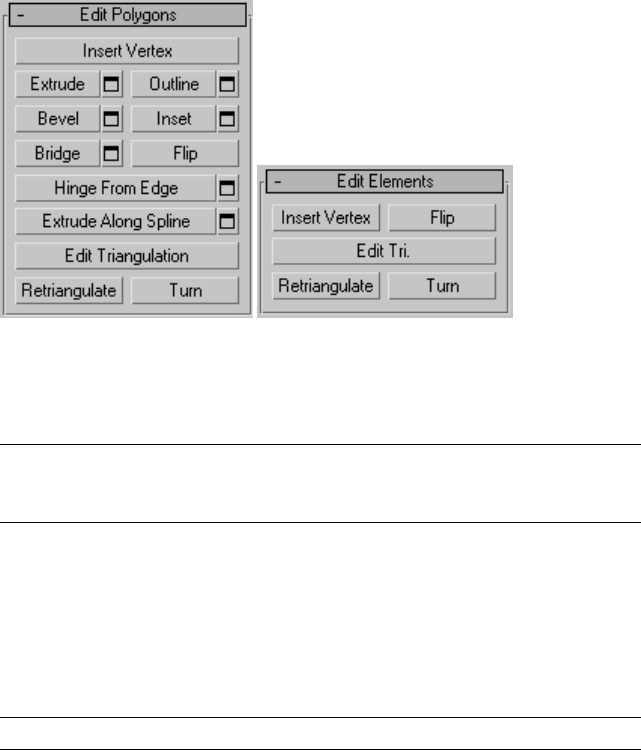
as Bend) applied to the object. This provides a magnet-like effect with a sphere
of influence around the selection.
For more information, see Soft Selection Rollout on page 1926 .
Edit Polygons/Elements rollout
At the Element sub-object level, this rollout includes commands common to
both polygons and elements, plus, at the Polygon level, some that are unique
to polygons. The commands available at both levels are Insert Vertex, Flip,
Edit Triangulation, Retriangulate, and Turn.
NOTE To delete polygons or elements, select them and press the Delete key. If
Delete Isolated Vertices on page 2117 is off, this can result in isolated vertices; that
is, vertices with no associated face geometry.
Insert Vertex Lets you subdivide polygons manually. Applies to polygons,
even if at the element sub-object level.
After turning on Insert Vertex, click a polygon to add a vertex at that location.
You can continue subdividing polygons as long as the command is active.
To stop inserting vertices, right-click in the viewport, or click Insert Vertex
again to turn it off.
NOTE In previous versions of the software, this command was called Divide.
Extrude Lets you perform manual extrusion via direct manipulation in the
viewport. Click this button, and then drag vertically on any polygon to extrude
it.
Edit Poly Modifier | 1351
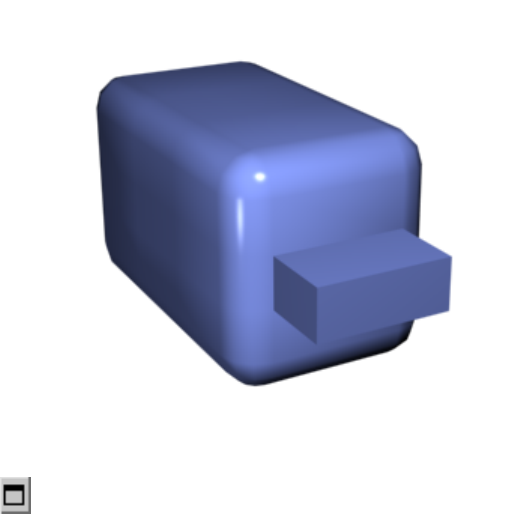
Extruding polygons moves them along a normal and creates new polygons
that form the sides of the extrusion, connecting the selection to the object.
Important aspects of polygon extrusion are:
■The mouse cursor changes to an Extrude cursor when over a selected
polygon.
■Drag vertically to specify the extent of the extrusion, and horizontally to
set the size of the base.
■With multiple polygons selected, dragging on any one extrudes all selected
polygons equally.
■You can drag other polygons in turn to extrude them while the Extrude
button is active. Click Extrude again or right-click in the active viewport
to end the operation.
Chamfer box showing extruded polygon
Extrude Settings Opens the Extrude Faces dialog on page 2141 , which
lets you perform extrusion via interactive manipulation.
If you click this button after performing an extrusion, the same extrusion is
performed on the current selection as a preview and the dialog opens with
Extrusion Height set to the amount of the last manual extrusion.
1352 | Chapter 9 Modifiers
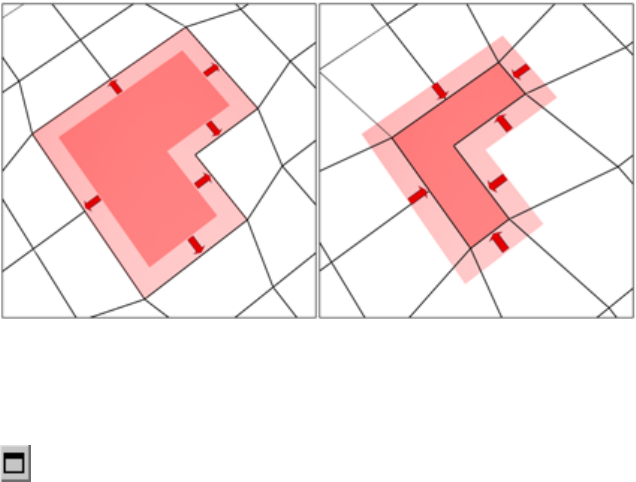
Outline Lets you increase or decrease the outside edge of each contiguous
group of selected polygons.
Outline is often used after an extrusion or bevel to adjust the size of the
extruded faces. It doesn't scale the polygons; only changes the size of the outer
edge. For example, in the following illustration, note that the sizes of the inner
polygons remain constant.
Click the Outline Settings button to open the Outline Selected Faces dialog,
which lets you perform outlining with a numeric setting.
Edit Poly Modifier | 1353

Extruded polygons (top), outline expanded (middle), outline reduced (bottom)
Note that the size of inner polygons doesn't change.
1354 | Chapter 9 Modifiers
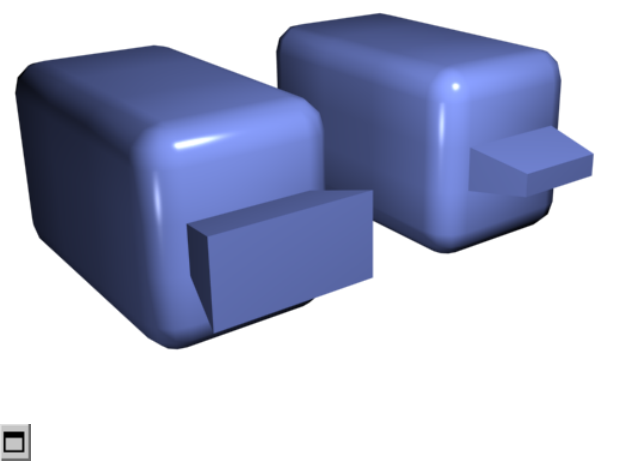
Bevel Lets you perform manual beveling via direct manipulation in the
viewport. Click this button, and then drag vertically on any polygon to extrude
it. Release the mouse button and then move the mouse vertically to outline
the extrusion. Click to finish.
■The mouse cursor changes to a Bevel cursor when over a selected polygon.
■With multiple polygons selected, dragging on any one bevels all selected
polygons equally.
■You can drag other polygons in turn to bevel them while the Bevel button
is active. Click Bevel again or right-click to end the operation.
Polygon beveled outward (left) and inward (right)
Bevel Settings Opens the Bevel Polygons dialog on page 2129 , which lets
you perform beveling via interactive manipulation.
If you click this button after performing a bevel, the same bevel is performed
on the current selection as a preview and the dialog opens with the same
settings used for the previous bevel.
Inset Performs a bevel with no height; that is, within the plane of the polygon
selection. Click this button, and then drag vertically on any polygon to inset
it.
■The mouse cursor changes to an Inset cursor when over a selected polygon.
Edit Poly Modifier | 1355
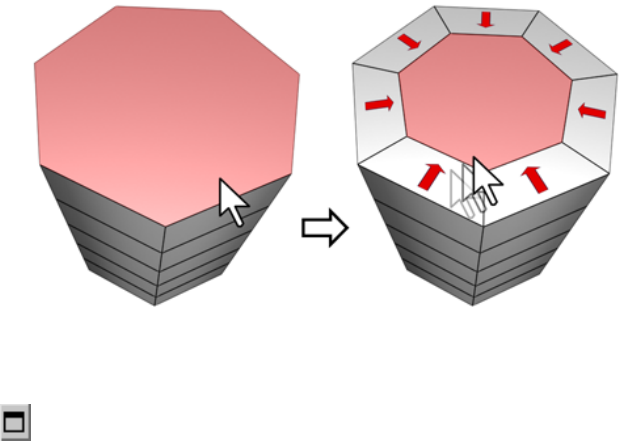
■With multiple polygons selected, dragging on any one insets all selected
polygons equally.
■You can drag other polygons in turn to inset them while the Inset button
is active. Click Inset again or right-click to end the operation.
Inset works on a selection of one or more polygons. As with Outline, only the outer
edges are affected.
Inset Settings Opens the Inset Selected Faces dialog on page 2144 , which
lets you inset polygons via interactive manipulation.
If you click this button after performing a manual inset, the same inset is
performed on the current selection as a preview and the dialog opens with
Inset Amount set to the amount of the last manual inset.
Bridge Connects two polygons or polygon groups on an object with a
polygon “bridge.” There are two ways to use Bridge in Direct Manipulation
mode (that is, without opening the Bridge Settings dialog):
■Make two separate polygon selections on the object, and then click Bridge.
This creates the bridge immediately using the current Bridge settings, and
then deactivates the Bridge button.
■If no qualifying selection exists (that is, two or more discrete polygon
selections), clicking Bridge activates the button and places you in Bridge
mode. First click a polygon and move the mouse; a rubber-band line
connects the mouse cursor to the clicked polygon. Click a second polygon
to bridge the two. This creates the bridge immediately using the current
1356 | Chapter 9 Modifiers
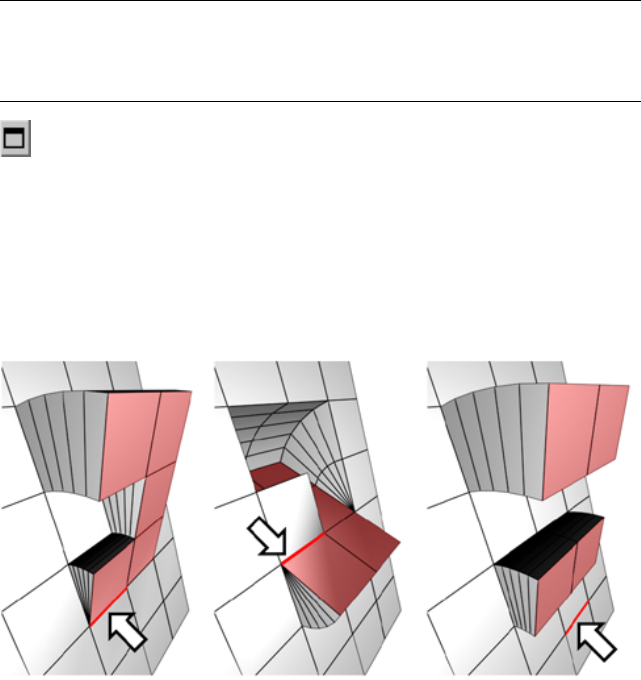
Bridge settings; the Bridge button remains active for connecting more pairs
of polygons. To exit Bridge mode, right-click the active viewport or click
the Bridge button.
NOTE Bridge always creates a straight-line connection between polygon pairs.
To make the bridge connection follow a contour, apply modeling tools as
appropriate after creating the bridge. For example, bridge two polygons, and
then use Bend on page 1139 .
Bridge Settings Opens the Bridge dialog on page 2131 , which lets you
connect pairs of polygon selections via interactive manipulation.
Flip Reverses the directions of the normals of selected polygons, hence their
facing.
Hinge From Edge Lets you perform a manual hinge operation via direct
manipulation in the viewport. Make a polygon selection, click this button,
and then drag vertically on any edge to hinge the selection. The mouse cursor
changes to a cross when over an edge.
The hinge edge needn't be part of the selection. It can be any edge of the mesh. Also,
the selection needn't be contiguous.
Hinging polygons rotates them around an edge and creates new polygons that
form the sides of the hinge, connecting the selection to the object. It's
essentially an extrusion with rotation, with one exception: If the hinge edge
belongs to a selected polygon, that side is not extruded. The manual version
of Hinge From Edge works only with an existing polygon selection.
Edit Poly Modifier | 1357
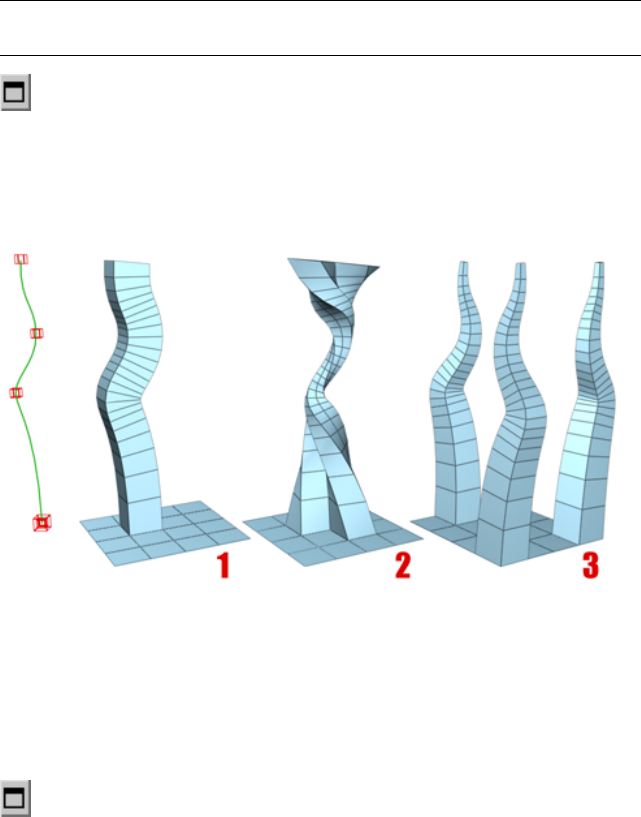
TIP Turn on Ignore Backfacing to avoid inadvertently hinging around a backfacing
edge.
Hinge Settings Opens the Hinge From Edge dialog on page 2143 , which
lets you hinge polygons via interactive manipulation.
If you click this button after performing a manual hinge, the dialog opens
with Angle set to the extent of the last manual hinge.
Extrude Along Spline Extrudes the current selection along a spline.
You can extrude a single face (1) or a selection of contiguous (2) or non-contiguous
faces (3). Extrusion 2 uses Taper Curve and Twist. Extrusion 3 uses Taper Amount; each
extrusion has a different curve rotation.
Make a selection, click Extrude Along Spline, and the select a spline in the
scene. The selection is extruded along the spline, using the spline's current
orientation, but as though the spline's start point was moved to the center of
each polygon or group.
Extrude Along Spline Settings Opens the Extrude Polygons Along Spline
dialog on page 2139 , which lets you extrude along splines via interactive
manipulation.
Edit Triangulation Lets you modify how polygons are subdivided into
triangles by drawing internal edges.
1358 | Chapter 9 Modifiers
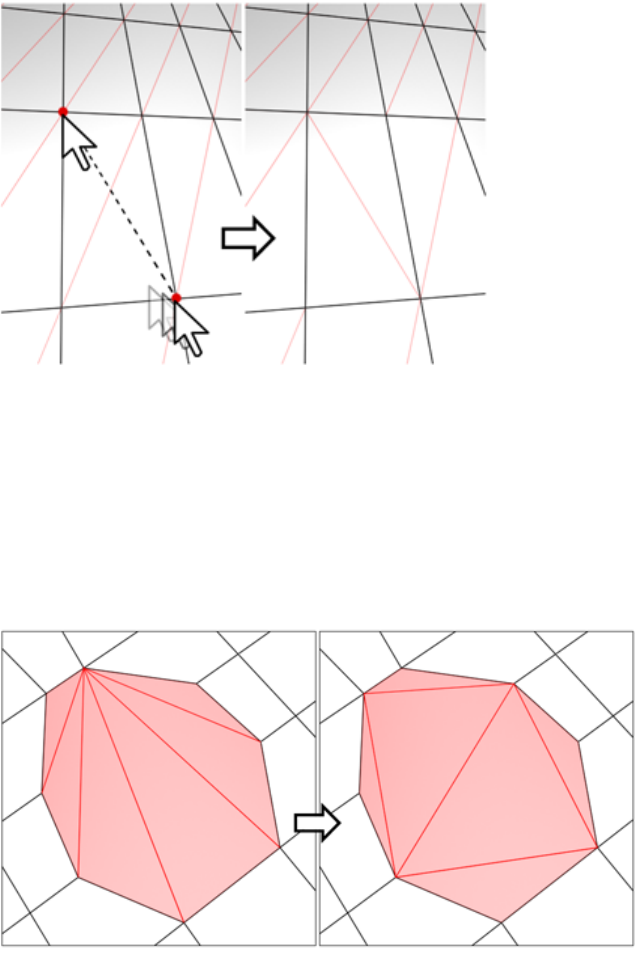
In Edit Triangulation mode, you can see the current triangulation in the viewport, and
change it by clicking two vertices on the same polygon.
To edit triangulation manually, turn on Edit Triangulation. The hidden edges
appear. Click a polygon vertex. A rubber-band line appears, attached to the
cursor. Click a non-adjacent vertex to create a new triangulation for the
polygon. You can continue clicking vertices to retriangulate, or right-click in
the viewport to exit this mode.
Retriangulate Lets the software automatically perform optimal triangulation
on the polygon or polygons currently selected.
Retriangulate attempts to optimize the subdivision of selected polygons into triangles.
Edit Poly Modifier | 1359
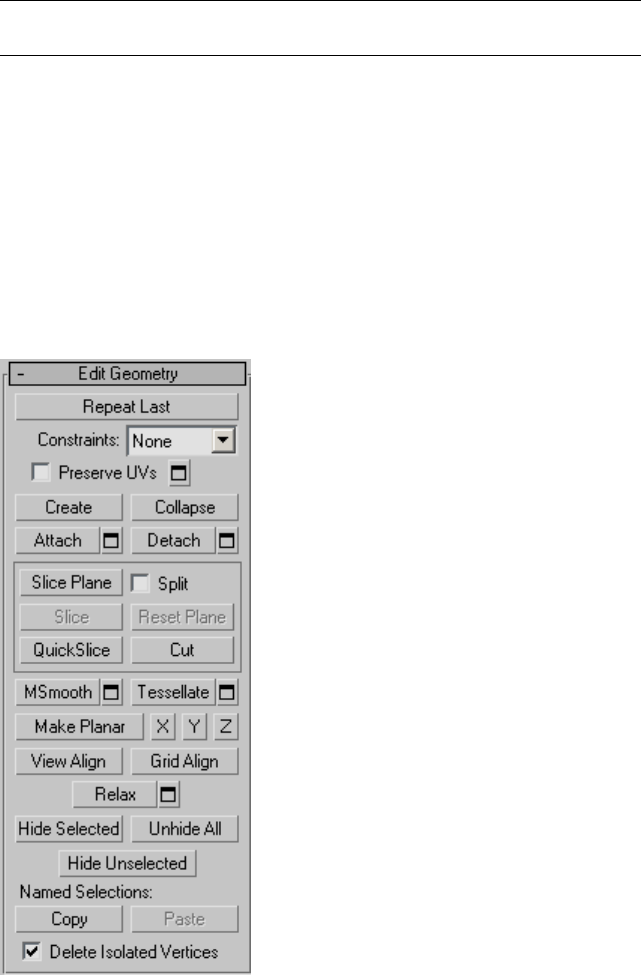
TIP For easier editing of triangulation, use the Turn command instead (see
following).
Turn Lets you modify how polygons are subdivided into triangles by clicking
diagonals. When you activate Turn, the diagonals on page 7757 become visible
as dashed lines in wireframe and edged-faces views. In Turn mode, click a
diagonal to change its position. To exit Turn mode, right-click in the viewport
or click the Turn button again.
Each diagonal has only two available positions at any given time, so clicking
a diagonal twice in succession simply returns it to its original position. But
changing the position of a nearby diagonal can make a different alternate
position available to a diagonal.
Edit Geometry rollout
1360 | Chapter 9 Modifiers
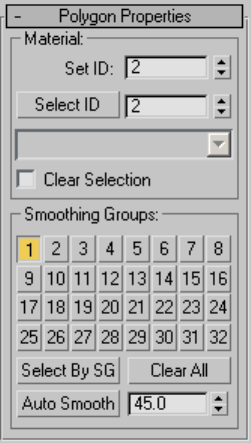
See Edit Geometry Rollout (Edit Poly Modifier) on page 1363 for detailed
descriptions of these controls.
Polygon Properties rollout
These controls let you work with material IDs and smoothing groups.
Material group
Set ID Lets you assign a particular material ID on page 7842 number to selected
sub-objects for use with multi/sub-object materials on page 5558 and other
applications. Use the spinner or enter the number from the keyboard. The
total number of available IDs is 65,535.
Select ID Selects sub-objects corresponding to the Material ID specified in
the adjacent ID field. Type or use the spinner to specify an ID, then click the
Select ID button.
[Select By Name] This drop-down list shows the names of sub-materials if
an object has a multi/sub-object material assigned to it. Click the drop arrow
and choose a sub-material from the list. This selects any sub-objects assigned
that material. If an object does not have a multi/sub-object material assigned,
the name list is unavailable. Likewise, if multiple selected objects have an Edit
Patch, Edit Spline, or Edit Mesh modifier applied, the name list is inactive.
Edit Poly Modifier | 1361

NOTE Sub-material names are those specified in the Name column on the
material's multi/sub-object Basic Parameters rollout. By default, 3ds Max assigns
the material name “No Name” followed by a sequence number in parentheses.
These names don't appear in the Material Editor, but they do show up in the
drop-down list.
Clear Selection When on, choosing a new ID or material name unselects
any previously selected sub-objects. When off, selections are cumulative, so
new ID or sub-material name selections add to the existing selection set of
patches or elements. Default=off.
Smoothing Groups group
Use these controls to assign selected polygons to different smoothing groups
on page 7932 , and to select polygons by smoothing group.
To assign polygons to one or more smoothing groups, select the polygons,
and then click the number(s) of the smoothing group(s) to assign them to.
Select By SG (Smoothing Group) Displays a dialog that shows the current
smoothing groups. Select a group by clicking the corresponding numbered
button and clicking OK. If Clear Selection is on, any previously selected
polygons are first unselected. If Clear Selection is off, the new selection is
added to any previous selection set.
Clear All Removes any smoothing group assignments from selected polygons.
Auto Smooth Sets smoothing groups based on the angle between polygons.
Any two adjacent polygons are put in the same smoothing group if the angle
between their normals is less than the threshold angle, set by the spinner to
the right of this button.
[threshold] This numeric setting (to the right of Auto Smooth) lets you
specify the maximum angle between the normals of adjacent polygons that
determines whether those polygons will be put in the same smoothing group.
Paint Deformation rollout
Paint Deformation lets you stroke elevated and indented areas directly onto
object surfaces. For more information, see Paint Deformation Rollout on page
2125 .
1362 | Chapter 9 Modifiers
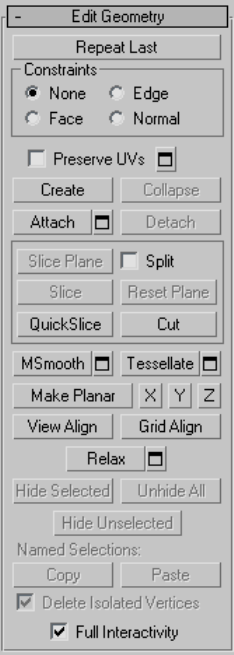
Edit Geometry Rollout (Edit Poly Modifier)
Select an Edit Poly object. > Modify panel > Edit Geometry rollout
The Edit Geometry rollout provides global controls for changing the geometry
of the Edit Poly object, at either the top (Object) level or the sub-object levels.
The control are the same at all levels, except as noted in the descriptions
below.
Interface
Repeat Last Repeats the most recently used command.
Edit Poly Modifier | 1363
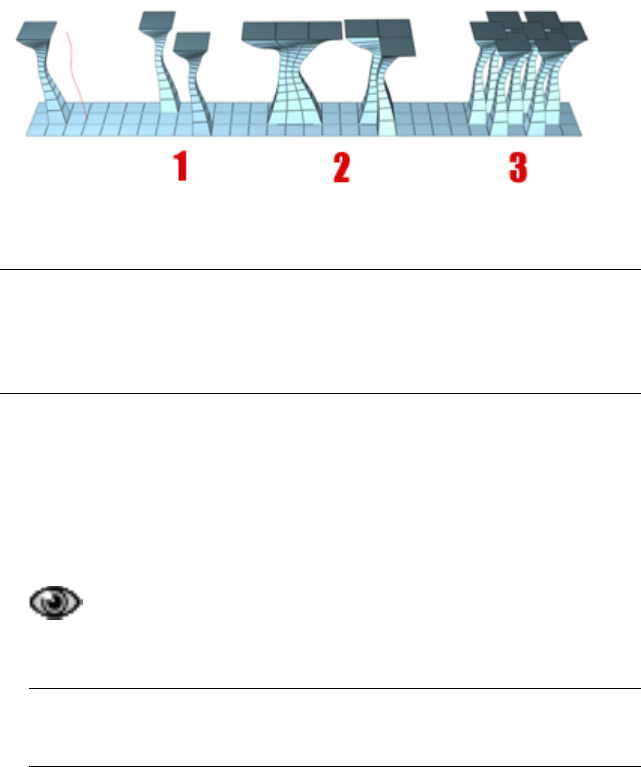
For example, if you extrude a polygon, and want to apply the same extrusion
to several others, select the others, and then click Repeat Last.
You can apply a spline extrusion of a single polygon (left) repeatedly to other single
polygons (1) or to multiple polygon selections, contiguous (2) or not (3).
NOTE Repeat Last does not repeat all operations. For example, it does not repeat
transforms. To determine which command will be repeated when you click the
button, check the button's tooltip, which gives the name of the last operation that
can be repeated. If no tooltip appears, nothing will happen when you click the
button.
Constraints Lets you use existing geometry to constrain sub-object
transformation. Choose the constraint type:
■None: No constraints. This is the default option.
■Edge: Constrains sub-object transformations to edge boundaries.
■Face: Constrains sub-object transformations to individual face surfaces.
■Normal: Constrains each sub-object’s transformations to its normal,
or the average of its normals. In most cases, this causes sub-objects to move
perpendicular to the surface.
NOTE This constraint works like the Push modifier on page 1574 , including the
fact that it operates on unmodified base normals. Edited normals are
unsupported.
1364 | Chapter 9 Modifiers
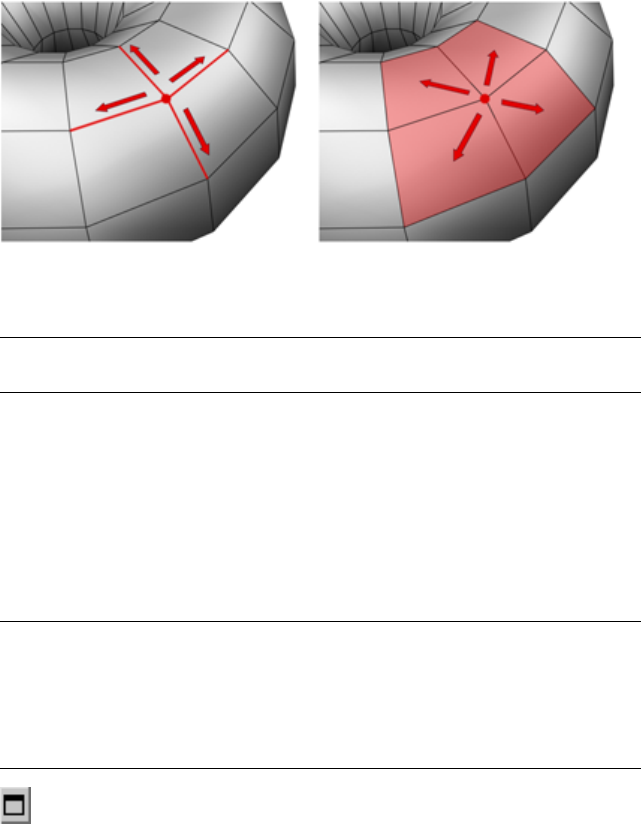
When set to Edge, moving a vertex will slide it along one of the existing edges,
depending on the direction of the transformation. If set to Face, the vertex moves only
on the polygon’s surface.
NOTE You can set constraints at the Object level, but their use pertains primarily
to sub-object levels. The Constraints setting persists at all sub-object levels.
Preserve UVs When on, you can edit sub-objects without affecting the object's
UV mapping. You can choose any of an object's mapping channels to preserve
or not; see Preserve UVs Settings, following. Default=off.
Without Preserve UVs, there is always a direct correspondence between an
object's geometry and its UV mapping. For example, if you map an object and
then move vertices, the texture moves along with the sub-objects, whether
you want it to or not. If you turn on Preserve UVs, you can perform minor
editing tasks without changing the mapping.
TIP For best results with Preserve UVs at the vertex level, use it for limited vertex
editing. For example, you'll usually have no trouble moving a vertex within edge
or face constraints. Also, it's better to perform one big move than several smaller
moves, as multiple small moves can begin to distort the mapping. If, however,
you need to perform extensive geometry editing while preserving mapping, use
the Channel Info utility on page 5858 instead.
Preserve UVs Settings Opens the Preserve Map Channels dialog on page
2146 , which lets you specify which vertex color channels and/or texture channels
(map channels) to preserve. By default, all vertex color channels are off (not
preserved), and all texture channels are on (preserved).
Edit Poly Modifier | 1365
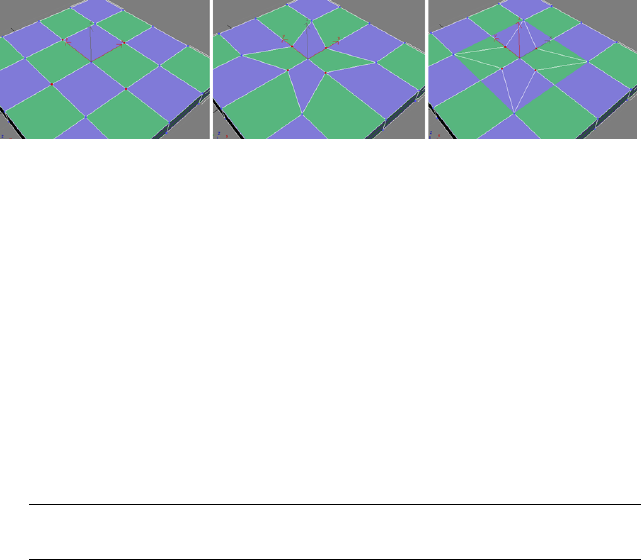
Original object (left); Scaled vertices with Preserve UVs off (center); Scaled vertices
with Preserve UVs on (right)
Create Lets you create new geometry. How this button behaves depends on
which level is active:
■Object, Polygon, and Element levels Lets you add polygons in the active
viewport. After you turn on Create, click three or more times in succession
anywhere, including on existing vertices, to define the shape of the new
polygon. To finish, right-click.
While creating a polygon at the Polygon or Element level, you can delete
the most recently added vertex by pressing Backspace. You can do this
repeatedly to remove added vertices in reverse order of placement.
You can start creating polygons in any viewport, but all subsequent clicks
must take place in the same viewport.
TIP For best results, click vertices in counterclockwise (preferred) or clockwise
order. If you use clockwise order, the new polygon will face away from you.
■Vertex level Lets you add vertices to a single selected poly object. After
selecting the object and clicking Create, click anywhere in space to add
free-floating (isolated) vertices to the object. The new vertices are placed
on the active construction plane unless object snapping is on. For example,
with face snapping on, you can create vertices on object faces.
■Edge and Border levels Creates an edge from vertex to vertex. Click
Create, click a vertex, and then move the mouse. A rubber-band line
extends from the vertex to the mouse cursor. Click a second, non-adjacent
vertex on the same polygon to connect them with an edge. Repeat, or, to
exit, right-click in the viewport or click Create again.
Edges you create separate the polygons. For example, by creating an edge
inside a quadrilateral polygon, you turn it into two triangles.
Collapse (Vertex, Edge, Border, and Polygon levels only) Collapses groups
of contiguous selected sub-objects by welding their vertices to a vertex at the
selection center.
1366 | Chapter 9 Modifiers

Attach Lets you attach another object in the scene to the selected editable
poly. You can attach any type of object, including splines, patch objects, and
NURBS surfaces. Attaching a non-mesh object converts it to editable-poly
format. Click the object you want to attach to the currently selected poly
object.
When you attach an object, the materials of the two objects are combined in
the following way:
■If the object being attached does not have a material assigned, it inherits
the material of the object it is being attached to.
■Likewise, if the object you're attaching to doesn't have a material, it inherits
the material of the object being attached.
■If both objects have materials, the resulting new material is a
multi/sub-object material on page 5558 that includes the input materials.
A dialog appears offering three methods of combining the objects' materials
and material IDs. For more information, see Attach Options Dialog on
page 2031 .
Attach remains active in all sub-object levels, but always applies to objects.
Attach List Lets you attach other objects in the scene to the selected
mesh. Click to open the Attach List dialog, which works like the Select From
Scene dialog on page 168 to let you choose multiple objects to attach.
Edit Poly Modifier | 1367
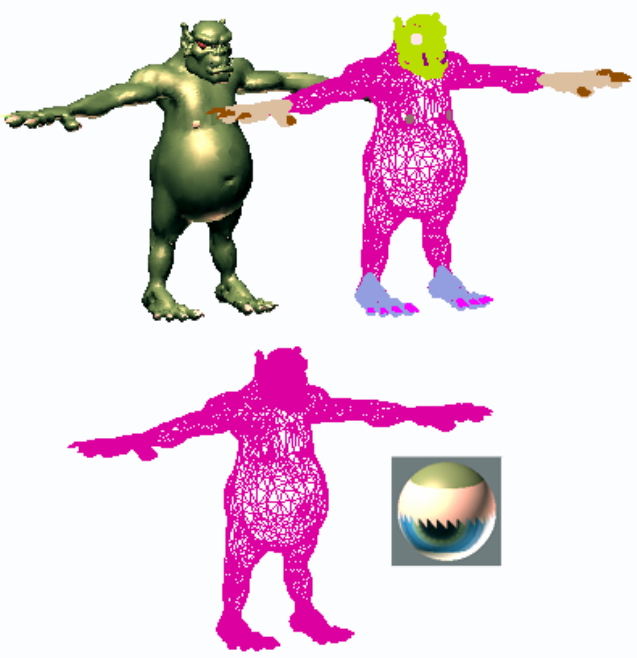
Shaded view of model (upper left); wireframe view of model (upper right); model with
objects attached (lower left); and subsequent multi/sub-object material (lower right)
Detach (sub-object levels only) Detaches the selected sub–objects and the
polygons attached to them as a separate object or element. The Detach As
Clone option copies the sub-objects rather than moving them.
You're prompted to enter a name for the new object. Detached faces leave a
hole in the original object when you move them to a new position, unless
you use the Detach As Clone option.
Cut and Slice group
These knife-like tools let you subdivide the poly mesh along a plane (Slice) or
in a specific area (Cut). Also see Full Interactivity on page 2117 .
1368 | Chapter 9 Modifiers
Slice Plane (sub-object levels only) Creates a gizmo for a slice plane that you
can position and rotate to specify where to slice. Also enables the Slice and
Reset Plane buttons.
If snapping is turned off, you see a preview of the slice as you transform the
slice plane. To perform the slice, click the Slice button.
Split When on, the QuickSlice and Cut operations create double sets of
vertices at the points where the edges are divided. This lets you easily delete
the new polygons to create holes, or animate the new polygons as separate
elements.
Slice (sub-object levels only) Performs the slice operation at the location of
the slice plane. Available only when Slice Plane is on. This tool slices the poly
just like the “Operate On: Polygons” mode of the Slice modifier on page 1658
.
Reset Plane (sub-object levels only) Returns the Slice plane to its default
position and orientation. Available only when Slice Plane is on.
QuickSlice Lets you quickly slice the object without having to manipulate
a gizmo. Make a selection, click QuickSlice, and then click once at the slice
start point and again at its endpoint. You can continue slicing the selection
while the command is active.
To stop slicing, right-click in the viewport, or click QuickSlice again to turn
it off.
Edit Poly Modifier | 1369
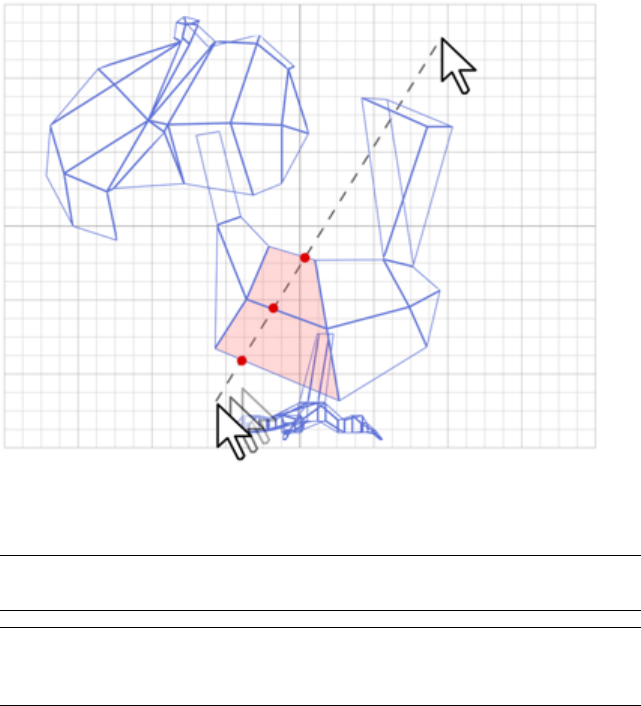
With Quickslice on, you can draw a line across your mesh in any viewport, including
Perspective and Camera views. The mesh is sliced interactively as you move the line
endpoint.
NOTE At the Object level, QuickSlice affects the entire object. To slice only specific
polygons, use QuickSlice on a polygon selection at the Poly sub-object level.
NOTE At the Polygon or Element sub-object level, QuickSlice affects only selected
polygons. To slice the entire object, use QuickSlice at any other sub-object level,
or at the object level.
Cut Lets you create edges from one polygon to another or within polygons.
Click at the start point, move the mouse and click again, and continue moving
and clicking to create new connected edges. Right-click once to exit the current
cut, whereupon you can start a new one, or right-click again to exit Cut mode.
1370 | Chapter 9 Modifiers
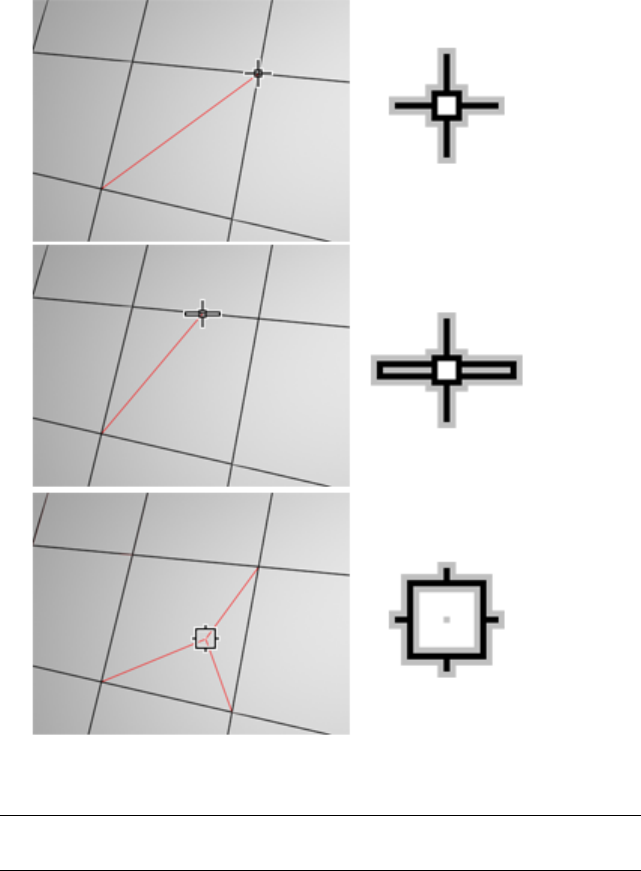
Cutting to a vertex (top); cutting an edge (center); cutting a polygon (bottom). Cut
is available at the object level and all sub-object levels.
NOTE You can use Cut with Turn for enhanced productivity. For more information,
see this procedure on page ? .
MSmooth Smoothes the object using the current settings. This command
uses subdivision functionality similar to that of the MeshSmooth modifier
on page 1460 with NURMS Subdivision, but unlike NURMS Subdivision, it
applies the smoothing instantly to the selected area of the control mesh.
Edit Poly Modifier | 1371
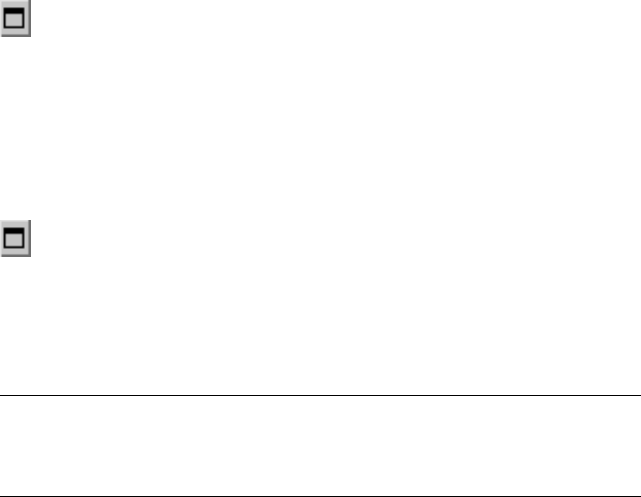
MSmooth Settings Opens the MeshSmooth Selection dialog on page
2145 , which lets you specify how smoothing is applied.
Tessellate Subdivides all polygons in the object based on the Tessellation
settings on page 2149 .
Tessellation is useful for increasing local mesh density while modeling. You
can subdivide any selection of polygons. Two tessellation methods are
available: Edge and Face.
Tessellate Settings Opens the Tessellate Selection dialog on page 2149 ,
which lets you specify how smoothing is applied.
Make Planar Forces all selected sub-objects to be coplanar. The plane's normal
is the average surface normal of the selection.
At the Object level, forces all vertices in the object to become coplanar.
TIP One application for Make Planar is making a flat side on an object. Normally,
you would use a contiguous selection set. If the selection includes vertices on
various parts of the object, the vertices are still made planar, but with distorting
effects on the rest of the geometry.
X/Y/Z Makes all selected sub-objects planar and aligns the plane with the
corresponding plane in the object's local coordinate system. The plane used
is the one to which the button axis is perpendicular; so, for example, clicking
the X button aligns the object with the local YZ axis.
At the Object level, makes all vertices in the object planar.
View Align Aligns all vertices in the object to the plane of the active viewport.
If a sub-object mode is active, this function affects only selected vertices or
those belonging to selected sub-objects. In the case of orthographic viewports,
using View Align has the same effect as aligning to the construction grid when
the home grid is active. When aligning to a perspective viewport (including
camera and light views), the vertices are reoriented to be aligned to a plane
that is parallel to the camera's viewing plane. This plane is perpendicular to
the view direction that is closest to the vertices' average position.
1372 | Chapter 9 Modifiers
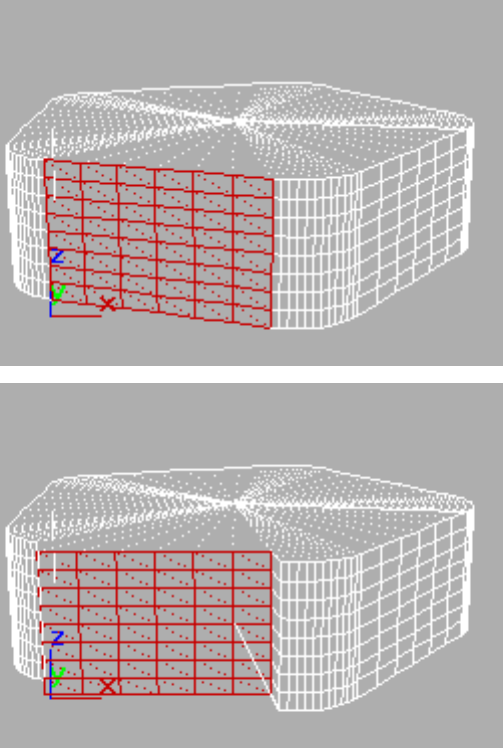
Above: Selected polygons in Perspective view
Below: Same polygons aligned to Front view
Grid Align Aligns all vertices in the selected object to the plane of the current
view. If a sub-object mode is active, function aligns only selected sub-objects.
This function aligns the selected vertices to the current construction plane.
The current plane is specified by the active viewport in the case of the home
grid. When using a grid object, the current plane is the active grid object.
Relax Applies the Relax function to the current selection, using the Relax
dialog settings (see following). Relax normalizes mesh spacing by moving each
Edit Poly Modifier | 1373
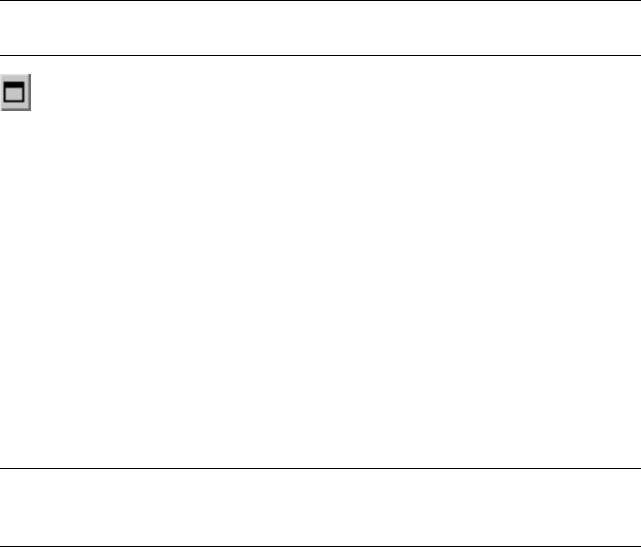
vertex toward the average location of its neighbors. It works the same way as
the Relax modifier on page 1575 .
NOTE At the object level, Relax applies to the entire object. At any sub-object
level, Relax applies only to the current selection.
Relax Settings Opens the Relax dialog on page 2148 , which lets you
specify how the Relax function is applied.
Hide Selected (Vertex, Polygon, and Element levels only) Hides any selected
sub-objectgs.
Unhide All (Vertex, Polygon, and Element levels only) Restores any hidden
sub-objects to visibility.
Hide Unselected (Vertex, Polygon, and Element levels only) Hides any
unselected sub-objects.
Named Selections (sub-object levels only)
Lets you copy and paste named selection sets of sub-objects between objects.
Start by creating one or more named selection sets, copy one, select a different
object, go to the same sub-object level, and then paste the set.
NOTE This function uses sub-object IDs, so if the target object's geometry differs
from that of the source object, the pasted selection will probably comprise a
different set of sub-objects.
For more information, see Named Selection Sets on page 146 .
Copy Opens a dialog that lets you specify a named selection set to place into
the copy buffer.
Paste Pastes the named selection from the copy buffer.
Delete Isolated Vertices (Edge, Border, Polygon, and Element levels
only) When on, deletes isolated vertices when you delete a selection of
contiguous sub-objects. When off, deleting sub-objects leaves all vertices intact.
Default=on.
1374 | Chapter 9 Modifiers
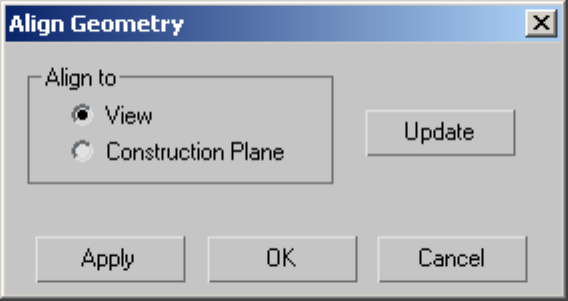
Align Geometry Dialog
Select an Edit Poly object. > Modify panel > object level or any sub-object level
> Animate mode > Edit Geometry rollout > Click View Align or Grid Align >
Edit Poly Mode rollout > Settings button
This Edit Poly-specific dialog lets you change the alignment method after
using the View Align or Grid Align function. Available only in Animate mode
after using the View Align or Grid Align command.
Interface
Align to Lets you choose what to align the selection with:
■View Aligns the selection with the view plane.
■Construction Plane Aligns the selection with the active grid.
Update Click this button to realign the selection with the designated entity
after changing it. Typically you'd use this with the View option after rotating
the view.
Detach Dialog
Select an Edit Poly object. > Modify panel > any sub-object level > Edit
Geometry rollout > Detach Settings button
This dialog lets you specify how a sub-object selection is detached from an
Edit Poly object.
Edit Poly Modifier | 1375
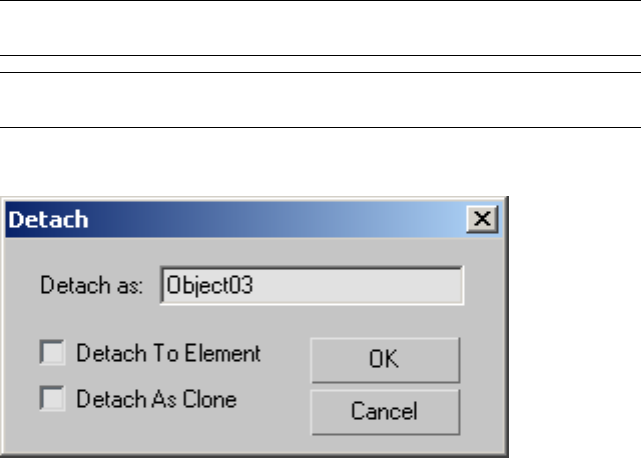
By default, both Detach To Element and Detach As Clone are off. Thus, when
you detach a sub-object selection, it's removed from the original object and
becomes a new object. The dialog options let you keep the detached item as
an element of the original object and/or detach it as a copy of the original
selection.
NOTE When you detach a vertex or an edge, any adjacent polygons are detached
as well. Also, a detached item remains in its original location.
NOTE Any Detach dialog settings you change are saved as program defaults
automatically.
Interface
Detach as Lets you assign a name to the new object. By default, the name
is "Object" followed by a sequence number.
This option is unavailable when Detach To Element is on.
Detach To Element The detached sub-object selection remains as part of
the original object, but becomes a new element. It can then be manipulated
independently at the Element sub-object level. Default=off.
Detach As Clone Detaches the selection as a copy of the original selection;
the latter remains intact. Default=off.
Edit Spline Modifier
Create or select a spline > Modify panel > Object–Space Modifiers > Edit Spline
Create or select a spline > Modifiers menu > Patch/Spline Editing > Edit Spline
1376 | Chapter 9 Modifiers
The Edit Spline modifier provides explicit editing tools for different levels of
the selected shape: vertex, segment, or spline. The Edit Spline modifier matches
all the capabilities of the base Editable Spline object, with the exceptions noted
below. For a complete parameter reference, see Editable Spline on page 590 .
The Rendering and Interpolation rollouts found in Editable Spline, which
allow manipulation of the spline's creation parameters, are not available in
the Edit Spline modifier. (The creation parameters are available in the modifier
stack on page 7427 for a spline to which Edit Spline is applied.) In addition, the
direct vertex animation capabilities of Editable Spline are not possible in Edit
Spline.
When possible, it’s far more efficient and reliable to perform explicit editing
at the Editable Spline level rather than store those edits within the Edit Spline
modifier. The Edit Spline modifier must copy the geometry passed to it, and
this storage can lead to large file sizes. The Edit Spline modifier also establishes
a topological dependency that can be adversely effected if earlier operations
change the topology being sent to it.
There are, however, situations where using Edit Spline is the preferred method.
■You want to edit a parametric shape as a spline, but want to retain the
ability to modify its creation parameters after the edit.
■You want to store your edits temporarily within Edit Spline until you are
satisfied with the results, before committing them permanently to an
editable spline object.
■You need to make edits across several shapes at once, but do not want to
convert them to a single editable spline object.
■You have a modifier in the stack that must stay parametric, and the
resulting spline must be edited after the modifier is applied.
Extrude Modifier
Select a shape. > Modify panel > Modifier List > Object-Space Modifiers >
Extrude
Select a shape. > Modifiers menu > Mesh Editing > Extrude
The Extrude modifier adds depth to a shape and makes it a parametric object.
Extrude Modifier | 1377
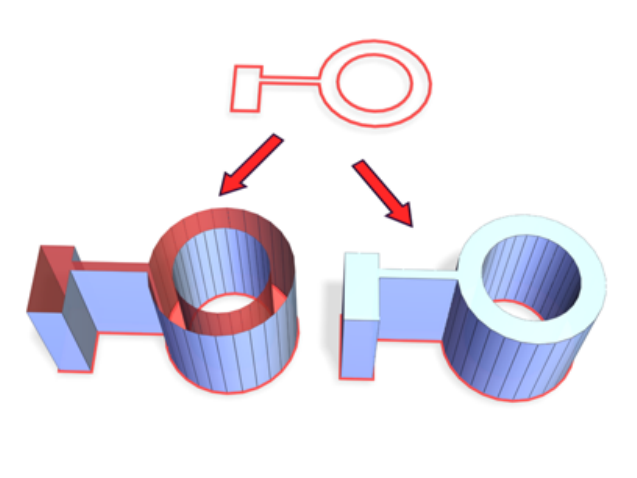
Above: Spline before extrusion
Below left: Extruded spline with Cap End off
Below right: Extruded spline with Cap End on
1378 | Chapter 9 Modifiers
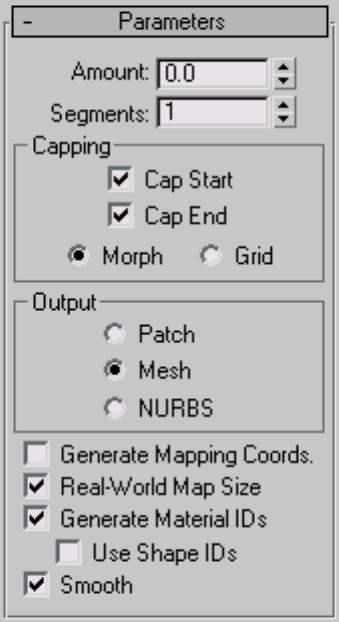
Interface
Amount Sets the depth of the extrusion.
Segments Specifies the number of segments that will be created in the
extruded object.
Capping group
Cap Start Generates a flat surface over the start of the extruded object.
Cap End Generates a flat surface over the end of the extruded object.
Morph Arranges cap faces in a predictable, repeatable pattern, which is
necessary for creating Morph targets on page 639 . Morph capping can generate
long, thin faces that don't render or deform as well as grid capping. Use morph
capping primarily if you're extruding multiple morph targets.
Extrude Modifier | 1379
Grid Arranges cap faces in a square grid trimmed at the shape boundaries.
This method produces a surface of evenly sized faces that can be deformed
easily by other modifiers. When you choose the Grid capping option, the grid
lines are hidden edges rather than visible edges. This primarily affects any
objects assigned a material with the Wire option turned on, or any objects
that use the Lattice modifier on page 1435 .
Output group
Patch Produces an object that you can collapse to a patch object; see Editing
the Stack on page 1023 .
Mesh Produces an object that you can collapse to a mesh object; see Editing
the Stack on page 1023 .
NURBS Produces an object that you can collapse to a NURBS surface; see
Editing the Stack on page 1023 .
Generate Mapping Coords Applies mapping coordinates to the extruded
object. Default=off.
When on, Generate Mapping Coordinates applies separate mapping coordinates
to the end caps, placing a single 1 x 1 tile on each cap.
Real-World Map Size Controls the scaling method used for texture mapped
materials that are applied to the object. The scaling values are controlled by
the Use Real-World Scale settings found in the applied material's Coordinates
rollout on page 5620 . Default=on.
Generate Material IDs Assigns different material IDs to the sides and the
caps of the extruded object. Specifically, the sides receive ID 3, and the caps
receive IDs 1 and 2.
This check box is turned on as a default when you create an extruded object,
but if you load an extruded object from a MAX file, the check box is turned
off, maintaining the same material ID assignment for that object as it had in
R1.x.
Use Shape IDs Uses the material ID values assigned to segments in the spline
on page 542 you extruded, or curve sub-objects in the NURBS on page 2152
curve you extruded.
Smooth Applies smoothing to the extruded shape.
1380 | Chapter 9 Modifiers
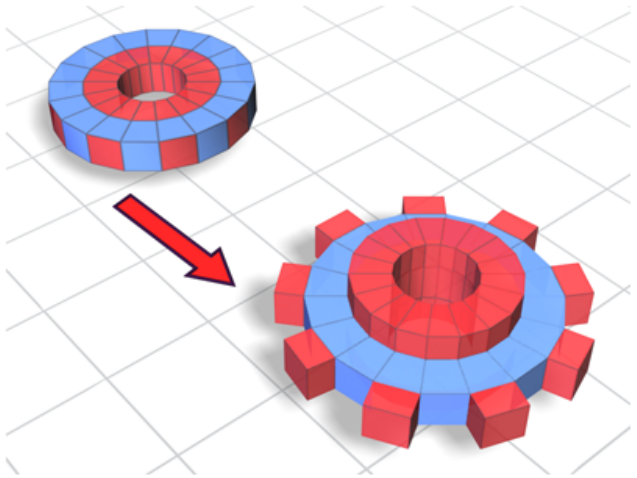
Face Extrude Modifier
Modify panel > Select one or more faces of a mesh object. > Modifier List >
Face Extrude
Modify panel > Select one or more faces of a mesh object. > Modifiers menu
> Mesh Editing > Face Extrude
The Face Extrude modifier extrudes faces along their normals, creating new
faces along the sides of the extrusion that connect the extruded faces to their
object. As with most modifiers, this affects the current face selection passed
up the stack. There are various differences between the Face Extrude modifier
and the Face Extrude function in an editable mesh on page 1990 , especially
the fact that all parameters in the Face Extrude modifier are animatable.
Faces extruded on the top and along the edge of the object
Face Extrude Modifier | 1381
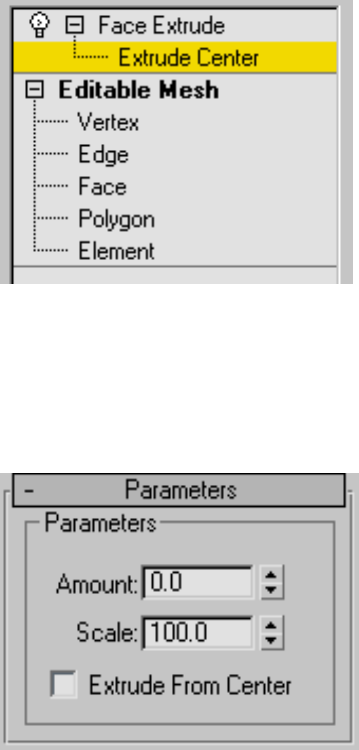
Interface
Modifier Stack
Extrude Center At this sub-object level, you can select and move (or animate)
the center point. This affects the geometry only if you turn on Extrude From
Center.
For more information on the stack display, see Modifier Stack on page 7427 .
Parameters rollout
Amount Determines the extent of the extrusion. You can adjust and readjust
the Amount spinner as often as you choose. To extrude a second level, apply
another Face Extrude modifier.
Scale Scales each cluster of selected faces independently about its center.
1382 | Chapter 9 Modifiers

NOTE By using multiple extrude modifiers with Scale, you can achieve a bevel
effect.
Extrude From Center Extrudes each vertex radially from the center point.
The direction in which the faces are extruded is slightly different than Face
Extrude in the editable mesh. Each vertex is displaced in the direction of the
average surface normal of selected faces that share that vertex. So each vertex
may move in a slightly different direction. Put another way, each vertex is
extruded in the direction of the surface normal at the point on the surface
where that vertex lies.
FFD (Free-Form Deformation) Modifiers
Modify panel > Make a selection. > Modifier List > Object-Space Modifiers >
FFD 2x2x2, FFD 3x3x3, or FFD 4x4x4
Make a selection. > Modifiers menu > Free Form Deformers > FFD 2x2x2, FFD
3x3x3, or FFD 4x4x4
FFD stands for Free-Form Deformation. Its effect is used in computer animation
for things like dancing cars and gas tanks. You can use it as well for modeling
rounded shapes such as chairs and sculptures.
The FFD modifier surrounds the selected geometry with a lattice. By adjusting
the control points of the lattice, you deform the enclosed geometry.
FFD (Free-Form Deformation) Modifiers | 1383
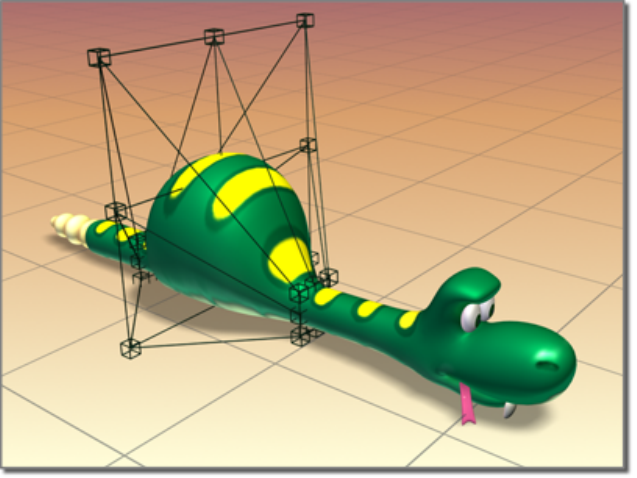
FFD deformation creates a bulge in the snake.
There are three FFD modifiers, each providing a different lattice resolution:
2x2, 3x3, and 4x4. The 3x3 modifier, for example, provides a lattice with three
control points across each of its dimensions or nine on each side of the lattice.
There are also two FFD-related modifiers that provide supersets of the original
modifiers; see FFD (Box/Cyl) modifier on page 1389 . With the FFD (Box/Cyl)
modifiers, you can set any number of points in the lattice, which makes them
more powerful than the basic FFD modifier.
Animating FFD Control Points and the Master Point Controller
Turn on the Auto Key button and move the lattice points to animate an FFD
and any underlying geometry. When you animate FFD control points, a Master
Point Controller is created automatically. In Track View the master controller
allows you to move multiple animated control points in time by simply moving
one master key (master keys display green in Track View).
1384 | Chapter 9 Modifiers
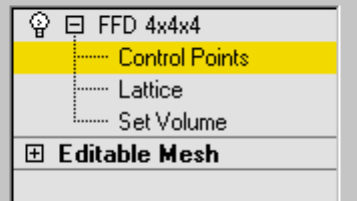
Procedures
To use an FFD modifier:
1Select the geometry. This can be the whole object, or you can use a Mesh
Select modifier to select a portion of the object's vertices.
2Apply the FFD 2X2, FFD 3X3, or FFD 4X4 modifier, depending on the
resolution of the lattice you want.
An orange lattice gizmo surrounds the geometry.
3In the modifier stack display, choose the Control Points sub-object level,
and then move the control points of the lattice to deform the underlying
geometry. To animate the deformation, turn on Auto Key.
The lattice volume defaults to the bounding box of the selected geometry.
However, you can position, rotate, and/or scale the lattice box so that it
modifies only a subset of vertices. Choose the Lattice sub-object level, and
then use any of the transform tools to adjust the lattice volume relative to the
geometry.
Interface
Modifier Stack
Control Points At this sub-object level, you can select and manipulate control
points of the lattice, one at a time or as a group (select multiple points using
standard techniques). Manipulating control points affects the shape of the
underlying object. You can use standard transformation methods with the
control points. If the Auto Key button is turned on when modifying the control
points, the points become animated.
Lattice At this sub-object level, you can position, rotate, or scale the lattice
box separately from the geometry. If the Auto Key button is turned on, the
lattice becomes animated. When you first apply an FFD, its lattice defaults to
FFD (Free-Form Deformation) Modifiers | 1385
a bounding box surrounding the geometry. Moving or scaling the lattice so
that only a subset of vertices lies inside the volume makes it possible to apply
a localized deformation.
Set Volume At this sub-object level, the deformation lattice control points
turn green, and you can select and manipulate control points without affecting
the modified object. This lets you fit the lattice more precisely to
irregular-shaped objects, giving you finer control when deforming.
Set Volume essentially lets you set the initial state of the lattice. If you use it
after you have animated a control point or when the Auto Key button is turned
on, then it works the same as at the Control Points sub-object level, deforming
the object as you manipulate points.
For more information on the stack display, see Modifier Stack on page 7427 .
1386 | Chapter 9 Modifiers
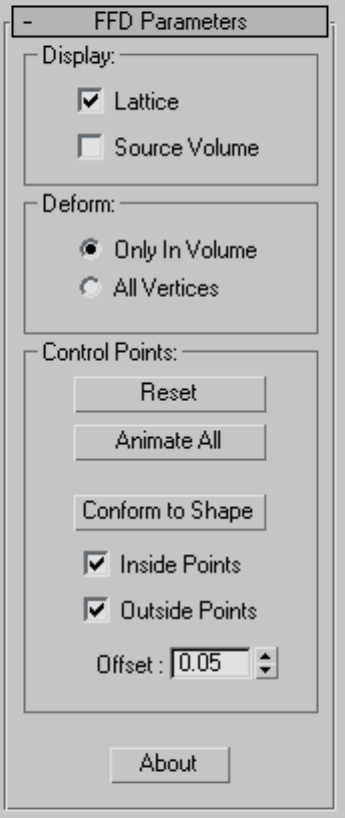
FFD Parameters rollout
Display group
Affects the display of the FFD in the viewports.
Lattice Draws lines connecting the control points to make a grid.
FFD (Free-Form Deformation) Modifiers | 1387
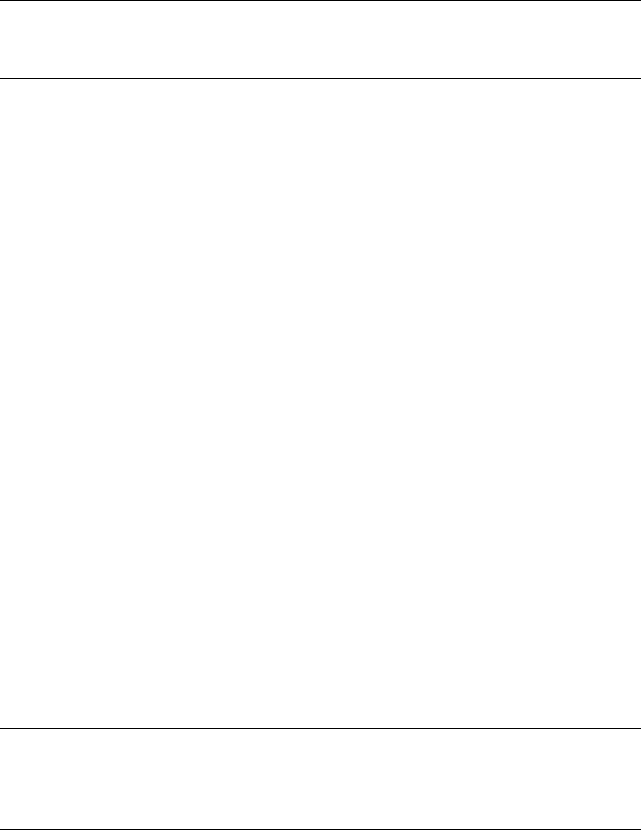
Although the viewports can sometimes become cluttered when these lines are
drawn, it helps to visualize the lattice.
Source Volume Displays the control points and lattice in their unmodified
state.
When you're in the Lattice selection level, this helps to position the source
volume.
TIP To see which points lie in the source volume (and therefore will be deformed),
temporarily deactivate the modifier by clicking to turn off the light bulb icon in
the modifier stack display.
Deform group
Only in Volume Deforms vertices that lie inside the source volume.
Default=on.
All Vertices Deforms all vertices, regardless of whether they lie inside or
outside the source volume.
The deformation outside the volume is a continuous extrapolation of the
deformation inside the volume. The deformation can be extreme for points
far away from the source lattice.
Control Points group
Reset Returns all control points to their original positions.
Animate All Assigns Point3 controllers to all control points so that they're
immediately visible in Track View.
By default the control points of an FFD lattice don't appear in Track View
because they don't have controllers assigned to them. But when a control
point is animated, a controller is assigned to it and becomes visible in Track
View. With Animate All, you can add and delete keys and perform other key
operations.
Conform to Shape Moves each FFD control point to the intersection of the
modified object with a straight line extending between the object's center to
the control point's original location, plus an offset distance specified by the
Offset spinner.
NOTE Conform to Shape works best with regular shapes, such as primitives. It's
less effective if the object has degenerate (long, narrow) faces or sharp corners.
All the controls are unavailable with shapes, because there are no faces to intersect
with.
1388 | Chapter 9 Modifiers
Inside Points Only control points inside the object are affected by Conform
to Shape.
Outside Points Only control points outside the object are affected by
Conform to Shape.
Offset The distance by which control points affected by Conform to Shape
are offset from the object surface.
About Displays a dialog with copyright and licensing information.
FFD (Box/Cylinder) Modifiers
Modify panel > Make a selection. > Modifier List > Object-Space Modifiers >
FFD(box) or FFD(cyl)
Make a selection. > Modifiers menu > Free Form Deformers > FFD Box or FFD
Cylinder
FFD stands for Free-Form Deformation. Its effect is used in computer animation
for things like dancing cars and gas tanks. You can use it as well for modeling
rounded shapes such as chairs and sculptures.
The FFD modifier surrounds the selected geometry with a lattice box. By
adjusting the control points of the lattice, you deform the enclosed geometry.
With the Auto Key button turned on, you can animate the lattice points, and
thus the deformation of the geometry.
FFD (Box/Cylinder) Modifiers | 1389
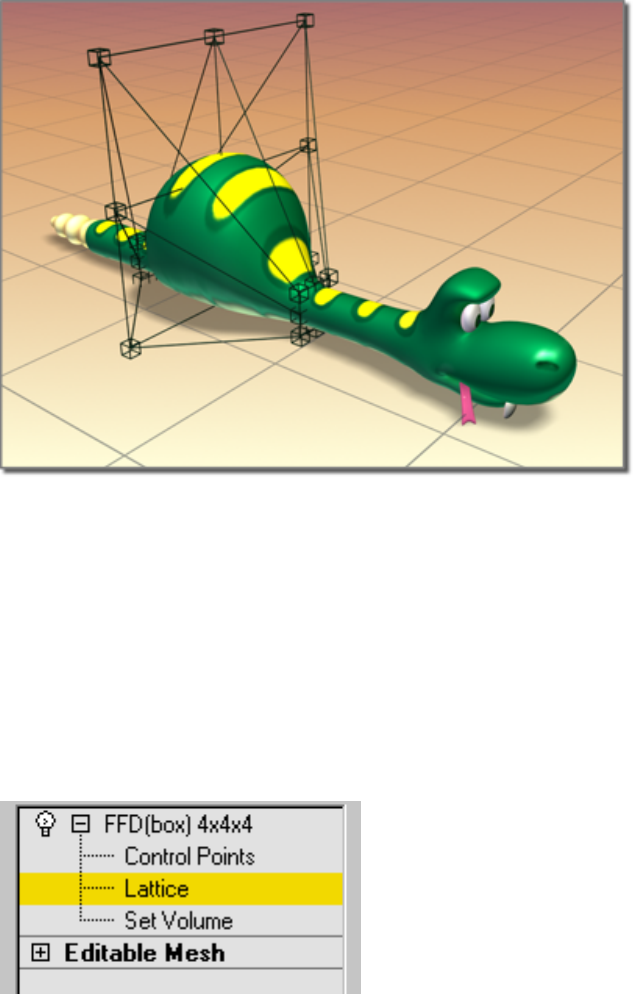
FFD deformation creates a bulge in the snake.
With the FFD(box) and FFD(cyl) modifiers you can create box-shaped and
cylinder-shaped lattice free-form deformation objects. Both are available as
object modifiers and as space warps.
The source lattice of an FFD modifier is fitted to the geometry it's assigned in
the stack. This can be a whole object, or a sub-object selection of faces or
vertices.
Interface
Modifier Stack
1390 | Chapter 9 Modifiers
Control Points At this sub-object level, you can select and manipulate control
points of the lattice, one at a time or as a group (select multiple points using
standard techniques). Manipulating control points affects the shape of the
underlying object. You can use standard transformation methods with the
control points. If the Auto Key button is turned on when modifying the control
points, the points become animated.
Lattice At this sub-object level, you can position, rotate, or scale the lattice
box separately from the geometry. If the Auto Key button is turned on, the
lattice becomes animated. When you first apply an FFD, its lattice defaults to
a bounding box surrounding the geometry. Moving or scaling the lattice so
that only a subset of vertices lie inside the volume makes it possible to apply
a localized deformation.
Set Volume At this sub-object level, the deformation lattice control points
turn green, and you can select and manipulate control points without affecting
the modified object. This lets you fit the lattice more precisely to
irregular-shaped objects, giving you finer control when deforming.
Set Volume essentially lets you set the initial state of the lattice. If a control
point is already animated or the Animate button is turned on, then Set Volume
works the same as at the Control Points sub-object level, deforming the object
as you manipulate points.
For more information on the stack display, see Modifier Stack on page 7427 .
FFD (Box/Cylinder) Modifiers | 1391

FFD Parameters rollout
1392 | Chapter 9 Modifiers
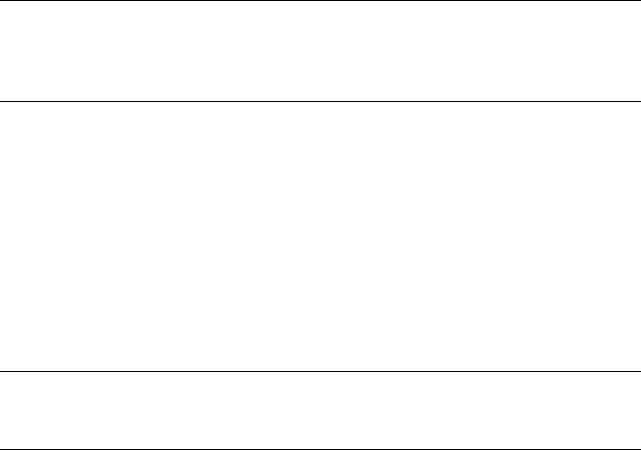
Dimensions group
Adjusts the unit dimensions of the source volume and specifies the number
of control points in the lattice. Note that the point dimensions also show up
beside the modifier name in the stack list.
Lattice dimensions The text displays the current number of control points
in the lattice (for example 3x4x4).
Set Number of Points Displays a dialog containing three spinners labeled
Length, Width, and Height, plus OK/Cancel buttons. Specify the number of
control points you want in the lattice, and then click OK to make the change.
WARNING Make changes to the lattice dimensions before you adjust the positions
of the lattice control points. When you change the number of control points with
this dialog, you lose any adjustments you've already made to the control points.
(You can undo this dialog.)
Display group
Affects the display of the FFD in the viewports.
Lattice Draws lines connecting the control points to make a grid. Although
the viewports can sometimes become cluttered when these extra lines appear,
they help to visualize the lattice.
Source Volume Displays the control points and lattice in their unmodified
state. This is an important display when you're adjusting the source volume
to affect specific vertices that lie inside or outside it.
TIP To see which points lie in the source volume (and therefore will be deformed),
temporarily deactivate the modifier by clicking to turn off the light bulb icon in
the modifier stack display.
Deform group
Provides controls that specify which vertices are affected by the FFD.
Only In Volume Deforms vertices that lie inside the source volume. Vertices
outside the source volume are not affected.
All Vertices Deforms all vertices regardless of whether they lie inside or
outside the source volume depending on the value in the Falloff spinner. The
deformation outside the volume is a continuous extrapolation of the
deformation inside the volume. Note that the deformation can be extreme
for points far away from the source lattice.
FFD (Box/Cylinder) Modifiers | 1393
Falloff Determines the distance from the lattice that the FFD effect will
decrease to zero. Available only when you choose All Vertices. When set to 0,
it's effectively turned off, and there is no falloff. All vertices are affected
regardless of how far they are from the lattice. The units of the Falloff
parameter are actually specified relative to the size of the lattice. A falloff of
1 means that the effect will go to 0 for points that are a lattice
width/length/height away from the lattice (depending on which side they
are).
Tension/Continuity Adjusts the tension and continuity of the deformation
splines. Although you can't actually see the splines in an FFD, the lattice and
control points represent the structure that controls the splines. As you adjust
the control points, you alter the splines (which move through each of the
points). The splines, in turn, deform the geometry of the object. By altering
the tension and continuity of the splines, you alter their effect on the object.
Selection group
Provides additional methods of selecting the control points. You can toggle
the state of any combination of the three buttons to select in one, two, or
three dimensions at once.
All X, All Y, All Z Selects all control points along the specified local dimension
when you select a control point. By turning on two buttons, you can select
all control points in two dimensions.
Control Points group
Reset Returns all control points to their original positions.
Animate All By default, the control points of an FFD lattice don't appear in
Track View because they don't have controllers assigned to them. But when
you animate a control point, a controller is assigned and it becomes visible
in Track View. You can also add and delete keys and perform other key
operations. Animate All assigns Point3 controllers to all control points so that
they're immediately visible in Track View.
Conform to Shape Moves each FFD control point to the intersection of the
modified object with a straight line extending between the object's center to
the control point's original location, plus an offset distance specified by the
Offset spinner.
1394 | Chapter 9 Modifiers

NOTE Conform to Shape works best with regular shapes, such as primitives. It's
less effective if the object has degenerate (long, narrow) faces or sharp corners.
All the controls are unavailable with shapes, because there are no faces for the
lattice to intersect with.
Inside Points Only control points inside the object are affected by Conform
to Shape.
Outside Points Only control points outside the object are affected by
Conform to Shape.
Offset The distance by which control points affected by Conform to Shape
are offset from the object surface.
About Displays a dialog with copyright and licensing information.
FFD (Free-Form Deformation) Select Modifier
Select an FFD space warp. > Modify panel > Modifier List > FFD Select
Select an FFD space warp. > Modifiers menu > Selection Modifiers > FFD Select
The FFD Select modifier works on an FFD (Box) Space Warp on page 2678 or
FFD (Cyl) Space Warp on page 2685 to change the selection of its control points,
and pass the selection up the stack.
The space-warp versions of the FFD modifiers provide sub-object geometry
that you can manipulate in the stack. For example, you can apply a Bend
modifier on page 1139 to an FFD space warp, bend its control points, and thus
bend the object to which the space warp is bound. Using the FFD Select
modifier, you can select a sub-object pattern of control points, and then use
the subsequent modifier(s) to deform the selected points.
The FFD Select modifier is especially useful for assigning Linked XForm
modifiers on page 1440 to portions of an FFD space warp.
Procedures
Example: To use the Linked XForm modifier with an FFD space warp:
1Create an object, an FFD space warp (such as FFD (Box) on page 2678 ),
and a couple of dummies on page 2531 .
2Bind the FFD space warp to the object you want to deform.
3Select the FFD space warp and apply an FFD Select modifier.
FFD (Free-Form Deformation) Select Modifier | 1395
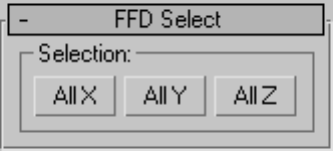
4In the Control Points sub-object mode, select the control points you want
to use to affect the object.
5Apply a Linked XForm modifier, and then pick one of the dummies as a
control object.
6Apply another FFD Select modifier, and select a different collection of
control points.
7Apply another Linked XForm modifier and assign the other dummy as
a control object.
8You can now move either of the dummy objects to both translate the
linked control points in the FFD space warp, and to deform the target
object.
Interface
All X/All Y/ All Z Select the control points corresponding to the specified
axis plane.
First click a selection button, and then select FFD control points in the
viewports.
Fillet/Chamfer Modifier
Select a shape. > Modify panel > Modifier List > Object-Space Modifiers >
Fillet/Chamfer
Select a shape. > Modifiers menu > Patch/Spline editing > Fillet/Chamfer
The Fillet/Chamfer modifier lets you fillet or chamfer the corners between
linear segments of Shape objects on page 7929 . Fillet rounds corners where
segments meet, adding new control vertices. Chamfer bevels corners, adding
another vertex and line segment. Note that this modifier works on the splines
at the sub-object level of the shape. It does not work between two or more
independent shape objects.
1396 | Chapter 9 Modifiers
When you apply Fillet/Chamfer, you're placed in a Vertex sub-object selection
level. You can select (and move) any vertex, but only Corner vertices and
Bezier Corner vertices are valid for fillet and chamfer functions. In addition,
both segments connected by a Bezier Corner vertex must be linear rather than
curved.
There are two methods for applying either fillets or chamfers:
■Select one or more valid corner vertices, and then adjust either the Radius
spinner to fillet the selected corners, or the Distance spinner to chamfer
the corners.
■You can preset the Radius or Distance values, and then select one or more
valid corner vertices, and click one of the Apply buttons to apply the
specified value to the selected vertices.
Fillet/Chamfer Modifier | 1397
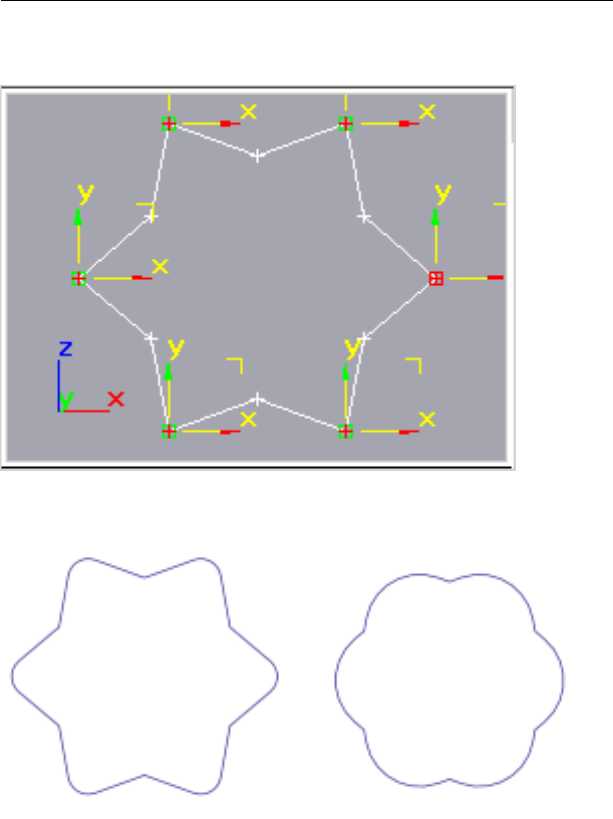
NOTE As of version 3 of 3ds Max, Edit/Editable Spline on page 606 includes
interactive fillet/chamfer functions. The only reason to use this modifier is to
apply it at a specific location on the stack.
Star with selected vertices
Fillet applied to above star with radius of 20 (left) and 40 (right)
1398 | Chapter 9 Modifiers
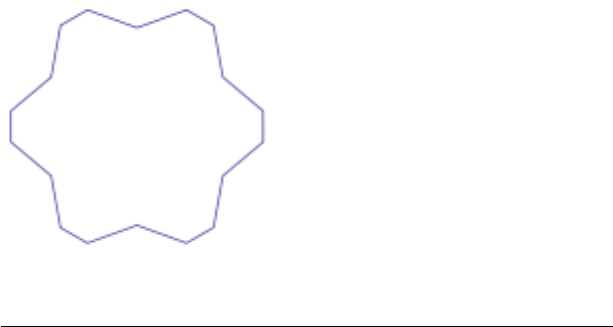
Chamfer applied to above star with distance of 20
Procedures
Example: To fillet/chamfer a star:
1Create a Star shape on page 567 .
2Apply a Fillet/Chamfer modifier.
3Select one or more of the star's vertices.
4Adjust the parameters to achieve different effects.
Fillet/Chamfer Modifier | 1399
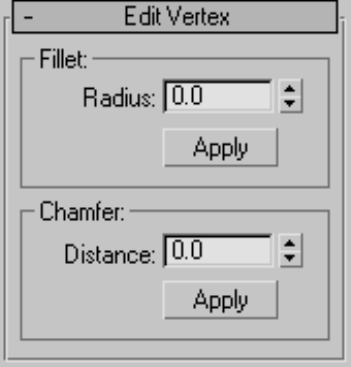
Interface
Fillet group
Radius Specifies the radius of the filleted corner.
Apply Applies the value specified in the Radius spinner to selected vertices.
For example, before selecting any vertices, set the Radius to the desired value,
then select your vertices and click Apply to fillet the selection with the specified
radius.
Chamfer group
Distance Specifies the distance of the new vertices from the original corner
vertex.
Apply Applies the value specified in the Distance spinner to selected vertices.
For example, before selecting any vertices, set Distance to the desired value,
then select your vertices and click Apply to chamfer the corners.
Flex Modifier
Select a Mesh , Patch, or NURBS object. > Modify panel > Modifier List >
Object-Space Modifiers > Flex
1400 | Chapter 9 Modifiers
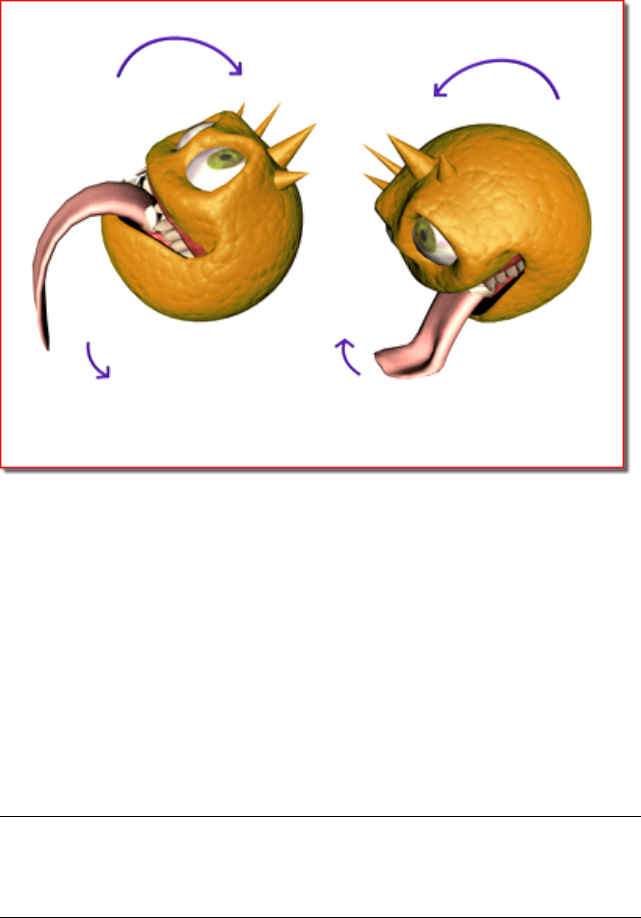
Select a Mesh, Patch, or NURBS object. > Modifiers menu > Animation
Modifiers > Flex Modifier
Flex causes the tongue to wag as the head rotates.
The Flex modifier simulates soft-body dynamics using virtual springs between
an object's vertices. You can set the springs' stiffness, or how actively they
keep vertices from coming close to each other, as well as stretch, or how far
apart they can move. At a more advanced level, you can also control the sway,
or how much the spring angle can change. At its simplest, this system causes
vertices to lag behind an object as it moves.
Flex works with NURBS, patches, meshes, shapes, FFD space warps, and any
plug-in-based object types that can be deformed. You can combine Flex with
space warps such as Gravity, Wind, Motor, Push, and PBomb to add realistic
physically based animation to an object. In addition, you can apply deflectors
to soft-body objects to simulate collision.
NOTE The Flex modifier is aware of vertex/control-point motion in any animated
modifier that deforms points below Flex in the modifier stack, such as the Morpher
modifier on page 1473 . Use this to simulate soft body motion on a morphed or
otherwise deform-animated object.
Flex Modifier | 1401
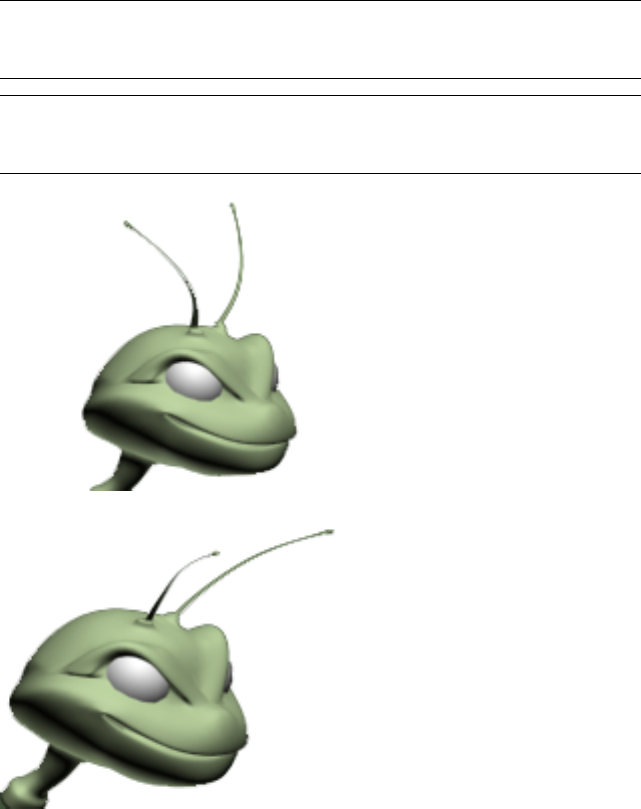
TIP After applying the Flex modifier to an object or sub-object selection, choose
the Flex modifier's Center sub-object and use Move to change where the flex effect
is centered.
TIP Using Flex's advanced capabilities can significantly impede real-time playback.
In such cases, use the Point Cache modifier on page 1533 to record the vertex
animation to disk, and then play it back using the cache.
The antennae, with the Flex modifier applied, move around like springs reacting to the
motion of the character's head.
Surfaces Influenced by the Flex Modifier
■On a mesh surface, the Flex modifier influences every vertex.
1402 | Chapter 9 Modifiers

■On a patch surface, the Flex modifier influences both control points and
tangent handles. Tangent handles are unlocked and moved independently
by the Flex modifier.
■On a NURBS surface, the Flex modifier influences control vertices (CVs)
or points.
■On a Spline (shape), the Flex modifier influences both control points and
tangent handles.
■On an FFD Space Warp, the Flex modifier influences control points.
Effects
You can apply space warps to the Flex modifier. For example, you can add
Wind to animate plants and trees, or a waving flag. In such cases, you don't
need to create keyframes to see the effects; the space warp alone can animate
the surface.
Character Animation
Use Flex above the Skin modifier on page 1600 to add secondary motion to a
character animated with Bones. If you are using the 3ds Max product, use Flex
above the Physique modifier to add secondary motion to a character.
Procedures
Example: To paint on weights:
1Create a sphere on the left side of the Top viewport.
2 Turn on the Auto Key button and move the time slider to
frame 50.
3In the Top viewport, move the sphere to the right side of the viewport.
4Turn off Auto Key.
5 On the Modify panel, click Modifier List, and then choose Flex.
The Flex modifier is applied to the sphere.
6 Click Play.
Flex Modifier | 1403
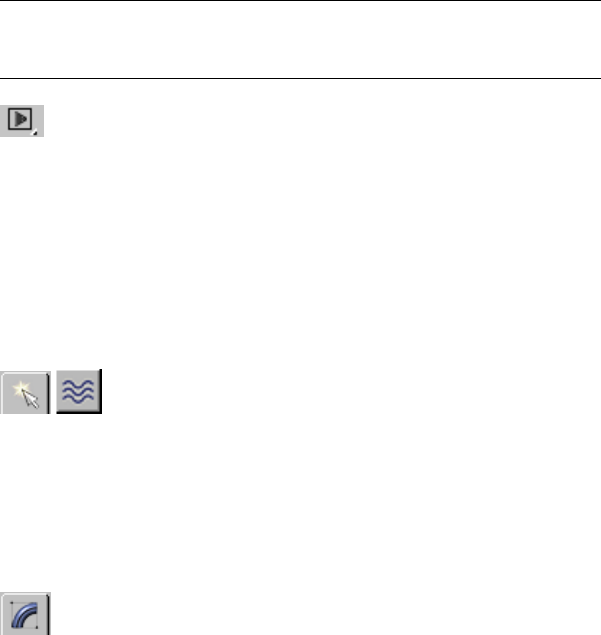
The sphere flexes around the Transform gizmo evenly.
7Open the Flex modifier hierarchy in the stack display, and click Weights
& Springs.
This enables modification of the Weights & Springs sub-object settings.
8In the Paint Weights group, turn on Paint.
9In the Left viewport, paint on the lower part of the sphere.
The vertex color changes as the vertex weight changes. Yellow vertices
are more rigid, blue vertices are less rigid.
NOTE You can change Flex vertex colors through Customize menu >
Customize User Interface > Colors > Geometry > Subselection
Hard/Medium/Soft.
10 Click Play.
The sphere wobbles on one side more than the other.
If the Strength setting in the Paint Vertex group is a positive value, you
paint rigidity. If the values are negative, you paint flexibility.
Paint with negative numbers for Strength to reverse the effect.
Example: To use wind as a force:
1In the Top viewport, create a sphere.
2 On the Create panel, click Space Warps, and then, if
necessary, choose Forces from the drop-down list.
3Click Wind, and then click and drag in the Front viewport to create a
wind gizmo.
4On the Wind Parameters rollout, set Strength and Turbulence to 4.
5Select the Sphere.
6 Apply the Flex modifier.
7On the Modify panel > Parameters rollout, set Samples to 1.
8On Forces and Deflectors rollout > Forces group, click the Add button,
and then select the Wind gizmo in the viewports.
1404 | Chapter 9 Modifiers

9 Click Play.
The sphere undulates in the wind. The Advanced Parameters rollout >
Reference Frame setting determines the frame where the force(s) in the
list take effect.
You can also use this example to see how the Chase Springs option works.
10 Turn off Chase Springs and click Play again.
The sphere keeps moving in the direction the wind is blowing without
"bouncing" back. That's because the chase springs, which attempt to
return the object to its original shape, are no longer in effect.
To add custom springs:
1Apply Flex to an object and go to the Weights & Springs sub-object level.
The Flex vertices appear at object vertices in the viewports.
2In the Advanced Springs rollout, turn on Show Springs.
3Click the Options button and in the Spring Option dialog on page 1418 ,
choose how you want to add springs. Exit the Spring Option dialog.
4Select vertices according to the options.
For instance, if you want to add one Hold Shape spring between two
vertices, select both vertices.
5Click Add Spring.
The new spring or springs appear. Edge springs are blue and Hold Shape
springs are red.
Example: To create a swinging rope:
1Use Create menu > Space Warps to add a Drag and a Gravity space warp
in the Top viewport.
2Use Create menu > Shapes > Line to create a line with ten vertices spaced
evenly in the top viewport.
3In the Modify panel, turn on Vertex sub-object and select all the vertices
except the first vertex.
4Add the Flex modifier.
5In the modifier stack view, open Weights and Springs sub-objects.
Flex Modifier | 1405
6Turn off Use Chase Springs.
7Turn off Use Weights.
8Set the solver to Runge-Kutta4.
9Set Samples to 5.
10 In a viewport, select all the points on the spline.
11 In the Advance Springs rollout, click the Option button.
12 In the dialog, turn on Hold Edge Length Springs and click OK.
13 Click Add Springs.
14 On the Forces and Deflectors rollout, add Gravity and Drag in the Forces
group.
15 Click Play.
The spline resembles a swinging rope.
Example: To create cloth draping on a sphere:
1Use Create menu > Space Warps to add a Drag and a Gravity space warp
in the Top viewport.
2Use Create menu > Space Warps > Deflectors > SDeflector to create a
spherical deflector. Set Bounce to 0 and Friction to 100. Place the deflector
below Z=0.
3Use Create menu > Geometry > Standard Primitives > Plane to create a
20 x 20 plane in the Top viewport. It should be above the spherical
deflector.
4Apply a Mesh Select modifier to the plane.
5In the Top viewport, select all the vertices except for the leftmost column.
6Apply the Flex modifier to the plane.
7Turn off Use Chase Springs and Use Weights.
8Set Samples to 3.
9Click Create Simple Soft Body.
10 In the Forces and Deflectors rollout, add the Gravity and Drag forces.
11 In the Forces and Deflectors rollout, add the spherical deflector.
1406 | Chapter 9 Modifiers
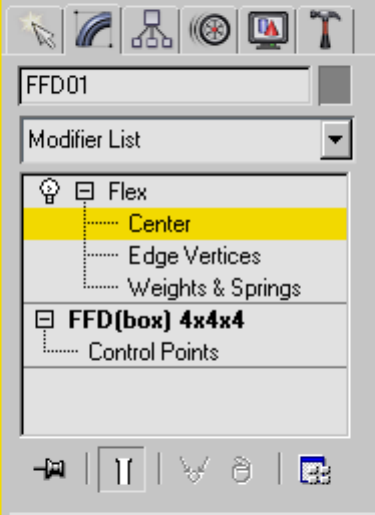
12 Click Play.
The plane drapes over the spherical deflector like cloth.
Interface
Modifier Stack
These modifier sub-object levels are available in the stack display by opening
the modifier hierarchy (click the + icon to the left of the modifier name).
Center Move the Transform gizmo in the viewports to set the center of the
effect.
The flex effect increases as the distance between the center and a vertex
increases.
Edge Vertices Select vertices in the viewports to control the falloff and
direction of the flex effect.
Selected vertices flex less than unselected vertices.
Flex Modifier | 1407
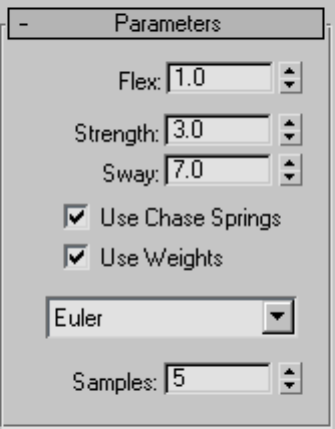
Weights & Springs Use the Weights And Painting rollout controls to select
and deselect vertices for subsequent operations in the Weights And Painting
rollout and the Advanced Springs rollout.
You can paint weights at any sub-object level, and add and remove springs at
any sub-object level (or even at the Flex modifier object level), but while a
Weights & Springs selection is active, only the selected vertices are affected.
Parameters rollout
Flex Sets the amount of flex and bend. Range=0 to 1000; Default=1.
This value represents the amount of the flexed animation that is used; the
flexed animation is determined by other factors such as motion and vertex
weighting. The default setting of 1 causes the flexed animation to occur
unmodified; higher settings cause unnaturally high amounts of stretching,
and lower settings cause diminished stretching.
Strength Sets the overall spring strength of the chase springs.
A value of 100 is rigid. Range=0 to 100; Default=3.
Sway Sets the time for the object to come to rest for chase springs.
Lower values increase the time for the object to come to rest. Range=0 to 100;
Default=7.
1408 | Chapter 9 Modifiers
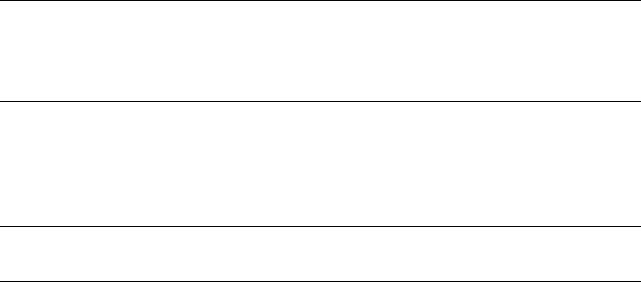
Use Chase Springs When on, enables chase springs, which force the object
to return to its original shape. When off, no chase springs are used, and the
amount by which vertices move depends only on their weights. Default=on.
Typically, for soft-body simulations when you want objects to be influenced
by forces and deflectors, you would turn off Use Chase Springs.
Use Weights When on, Flex recognizes the different weights assigned to an
object's vertices, applying different amounts of flexing accordingly. When off,
the flex effect applies itself to the object as a monolithic whole. Default=on.
Typically, for soft-body simulations when you want objects to be influenced
by forces and deflectors, you would turn off Use Weights.
Solver Type Choose a solver for the simulation from the drop-down list. The
three choices are Euler, Midpoint, and Runge-Kutta4. Midpoint and
Runge-Kutta4 require successively more computation than Euler, but are more
stable and accurate. Default=Euler.
TIP In most cases, you can use Euler successfully, but if unexpected object
deformations occur during a simulation, try using one of the more accurate solver
types. Specifically, you might need to use Midpoint or Runge-Kutta4 with higher
Stretch and Stiffness settings.
Samples The number of times per frame the Flex simulation is run at equal
time intervals. The more samples you take, the more accurate and stable the
simulation. When using the Midpoint or Runge-Kutta4 solver, you might not
need as many samples as with Euler. Default=5.
TIP If your simulation produces unexpected results, such as object vertices moving
to seemingly random locations, try increasing the Samples setting.
Flex Modifier | 1409
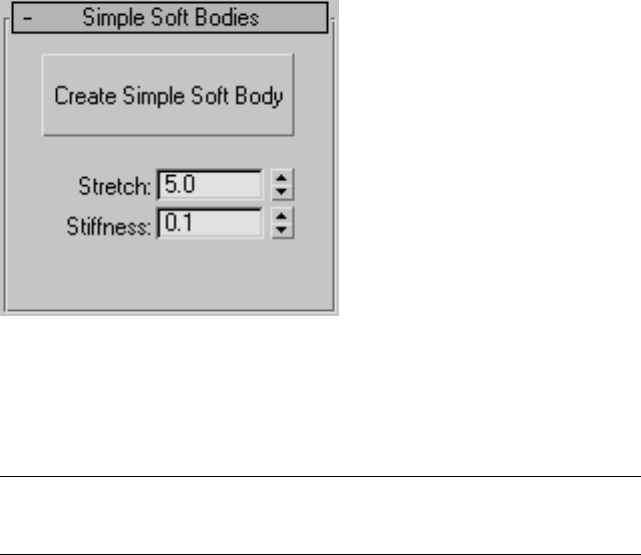
Simple Soft Bodies rollout
Lets the software determine spring settings for the entire object automatically.
Alternatively, you can use the Advanced Springs on page 1416 rollout settings
to specify spring settings between each pair of vertices.
Create Simple Soft Body Generates spring settings for the object based on
the Stretch and Stiffness settings.
NOTE After you use Create Simple Soft Body, you can change the Stretch and
Stiffness settings without having to click the button again; the changes take effect
immediately.
Stretch Determines how much object edges can elongate. When Advanced
Springs rollout > Enable Advanced Springs is off, the Stretch setting is linked
to the Advanced Springs rollout > Stretch Str. and Stretch Sway settings.
Stiffness Determines how rigid the object is. When Advanced Springs rollout
> Enable Advanced Springs is off, the Stretch setting is linked to the Advanced
Springs rollout > Shape Str. and Shape Sway settings.
The differences between Stretch and Stiffness are subtle, and understanding
them is further complicated by the fact the two affect each other. In addition,
how they work depends on object topology. For example, say you create a
box, add a Flex modifier, apply Create Simple Soft Body, and then set a high
Stretch value and a low Stiffness value. If you use the box in a Flex-based
dynamics simulation, such as dropping it onto a surface (deflector) with
gravity, you might expect the box to fall over and flatten out. But instead,
because of the box's topology, which causes Create Simple Soft Body to apply
a relatively small number of shape springs, you'd actually get better results
with a low Stretch value and a high Stiffness value. However, if you use a
1410 | Chapter 9 Modifiers
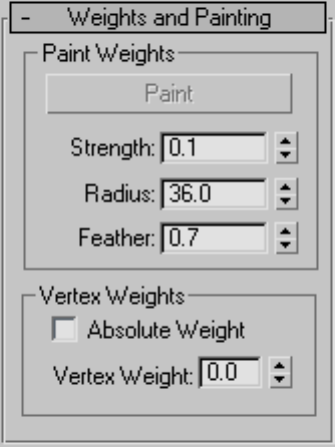
sphere of eight segments instead, you'll get the collapsing behavior with the
default Stretch and Stiffness settings, and as expected, increasing rigidity with
higher Stiffness settings.
In soft-body simulations, such as the above-cited example of dropping an
object onto a surface, particularly with dense meshes, you might get better
results by applying the mesh to an FFD space warp that's bound to the object.
If the object's shape isn't suitable for use with the space warp, you might have
to instead use the Advanced Springs on page 1416 rollout settings to apply
springs manually. In such cases, you should create shape springs between
opposite vertices rather than adjacent ones.
Cloth-like animation usually works best with a high Stretch setting and a low
Stiffness setting. For soft bodies, you would usually use high settings for both
Stretch and Stiffness, depending on how "squishy" you want the object to be.
Weights and Painting rollout
When you first apply Flex to an object, the modifier automatically sets vertex
weights based on distance from the modifier's center. The higher a vertex
weight, the less prone it is to being affected by Flex effects. The modifier applies
the highest weights to vertices closest to its center, and the lowest weights to
vertices farthest from the center. So, for example, with a cylinder whose pivot
point is at the base, you'll get the greatest amount of flexing at the top. But
Flex Modifier | 1411

with a sphere, all of whose vertices are equidistant from the pivot point
(center), all vertices have, by default, equal weight values.
The Paint Weights controls let you use a spherical brush with adjustable radius
and falloff to change vertex weights in the viewports, thus controlling the
amount of lag. The Vertex Weights controls let you apply absolute or relative
weighting to single vertices or groups of vertices.
Paint Weights group
Paint At any sub-object level, click Paint, and then drag the cursor over the
mesh in the viewports to "paint" vertex weights using the current Strength
and Feather settings. Vertex colors changes to reflect the new vertex weight.
Painting changes vertex weights relative to their current values; it does not
apply an absolute weight. Longer strokes over an area of the mesh will increase
or decrease vertex weights more than short strokes, and repeated strokes over
the same area will cause incremental changes in weight values unless they're
already at their extremes.
The vertex coloring shown at any Flex sub-object level provides an approximate
indication of weighting. The colors are determined by the settings in Customize
menu > Customize User Interface > Colors tab > Elements: Geometry. In this
list are three color entries: Subselection Hard, used to display vertices with the
highest Weight values; Subselection Medium, used to display vertices with
medium Weight values; and Subselection Soft, used to display vertices with
low Weight values.
Strength Sets the amount by which painting changes weight values. Higher
values change weighting more quickly. At Strength=0, painting does not
change weight values. Range=-1 to 1; Default=0.1.
Negative values allow you to remove weight.
TIP When painting, you can use the Alt key to invert the strength.
Radius Sets the size of the brush in world units. Range=.001 to 99999;
Default=36.
NOTE If you position the mouse cursor over the object before painting, you can
see a wireframe representation of the spherical "brush" that depicts the Radius
setting.
Feather Sets the falloff in strength from the center of the brush to its edge.
Default=.7. Range=.001 to 1.
1412 | Chapter 9 Modifiers

Vertices at the center of the brush are always changed by the full amount of
the Strength setting, but the higher the Feather setting, the less vertices closer
to the edge change. At the lowest setting, all vertices inside the radius are
changed equally.
Vertex Weights group
Sets vertex weighting manually. At the Weights & Springs sub-object level,
select vertices in the viewports, and then change the value of the Vertex
Weight parameter. Alternatively, turn on Absolute Weight, set the desired
Vertex Weight, and then select vertices to set; changes are immediate.
Absolute Weight Turn on to assign absolute weights to the selected vertices.
Turn off to add or remove weight based on the Vertex Weight setting.
Vertex Weight Assigns weight to selected vertices.
Depending on the state of the Absolute Weight parameter, weight assignment
is either absolute or relative.
NOTE The Vertex Weight range is -100 to 100. With Absolute Weight on, the
negative Vertex Weight settings have no effect; the effective range is 0 to 100.
With Absolute Weight off, changing the Vertex Weight setting adds the amount
to the current weights of selected vertices, and then the setting is reset to 0.
Flex Modifier | 1413
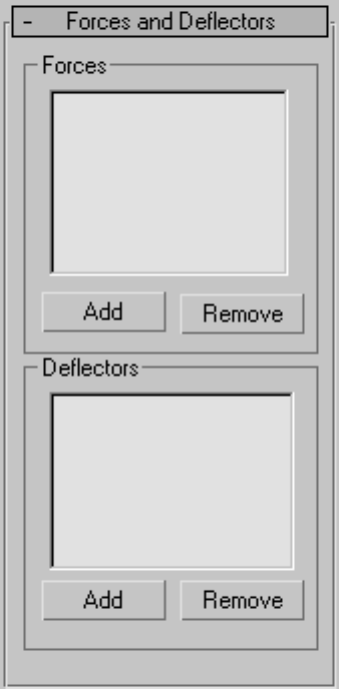
Forces and Deflectors rollout
Forces group
Use these controls to add space warps in the Forces category to the Flex
modifier. Supported space warps are:
■Displace on page 2645
■Drag on page 2624
■Gravity on page 2639
■Motor on page 2614
1414 | Chapter 9 Modifiers
■PBomb on page 2629
■Push on page 2609
■Vortex on page 2619
■Wind on page 2642
List Window Displays particle space warps applied to the Flex modifier.
Add Click this, and then select a particle space warp in the viewports to add
the effect to Flex. The added space warp displays in the list window.
Remove Select a space warp in the list and click Remove to remove the effect
from Flex.
Deflectors group
Using deflectors with Flex lets object movement be impeded by surfaces. This
lets you simulate collisions with soft-body objects. For best results with
collisions, in the deflector settings use a low value for Bounce and a high value
for Friction.
Supported deflectors are:
■POmniFlect on page 2650
■SOmniFlect on page 2661
■UOmniFlect on page 2664
■UDeflector on page 2672
■SDeflector on page 2669
■Deflector on page 2675
List Window Displays deflectors applied to the Flex modifier.
Add Click this, and then select a deflector in the viewports to add the effect
to Flex. The added deflector displays in the list window.
Remove Select a deflector in the list and click Remove to remove the effect
from Flex.
Flex Modifier | 1415
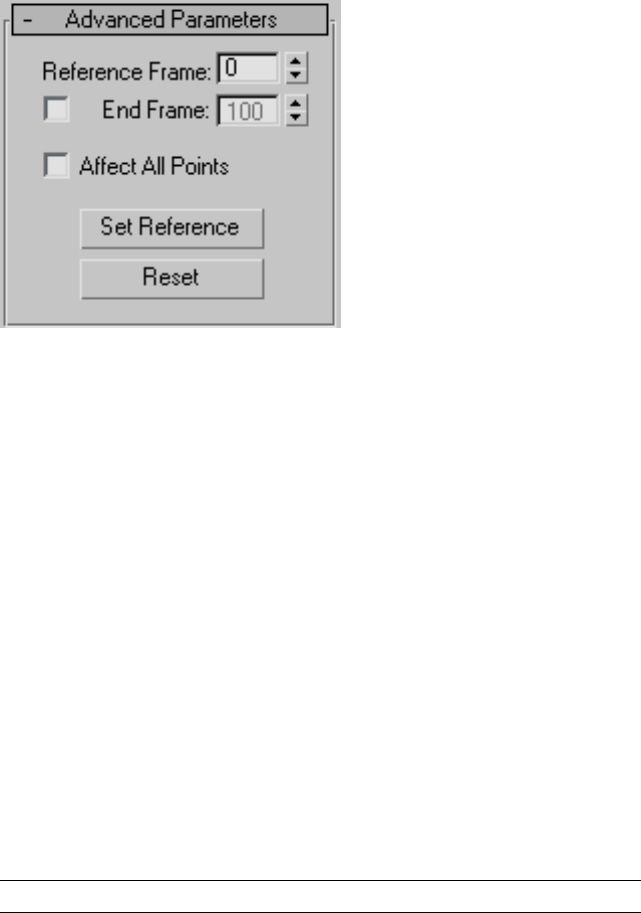
Advanced Parameters rollout
Reference Frame Sets the first frame at which Flex begins its simulation.
End Frame When on, sets the last frame at which Flex is to take effect. After
this frame, the object snaps back to its shape as currently defined by the stack.
For instance, if you animate a Bend modifier in the stack under Flex, then
when Flex stops, the object's shape is altered only by the Bend modifier settings
as of that frame.
Affect All Points Forces Flex to ignore any sub-object selection in the stack
and apply itself to the entire object.
Set Reference Updates the viewports.
After moving the effect center, click Set Reference to update the viewports.
Reset Resets vertex weighting to the defaults.
Advanced Springs rollout
Use these settings when you need a more precise springs setup than is provided
by the Simple Soft Body feature. Flex uses two types of spring: edge springs,
which create springs only along existing edges, and shape springs, which can
exist between any two vertices in the object that are not connected by an
edge. In general, add edge springs along existing edges and shape springs
between vertices that don't share an edge.
NOTE Before using these controls, go to the Weights & Springs sub-object level.
1416 | Chapter 9 Modifiers
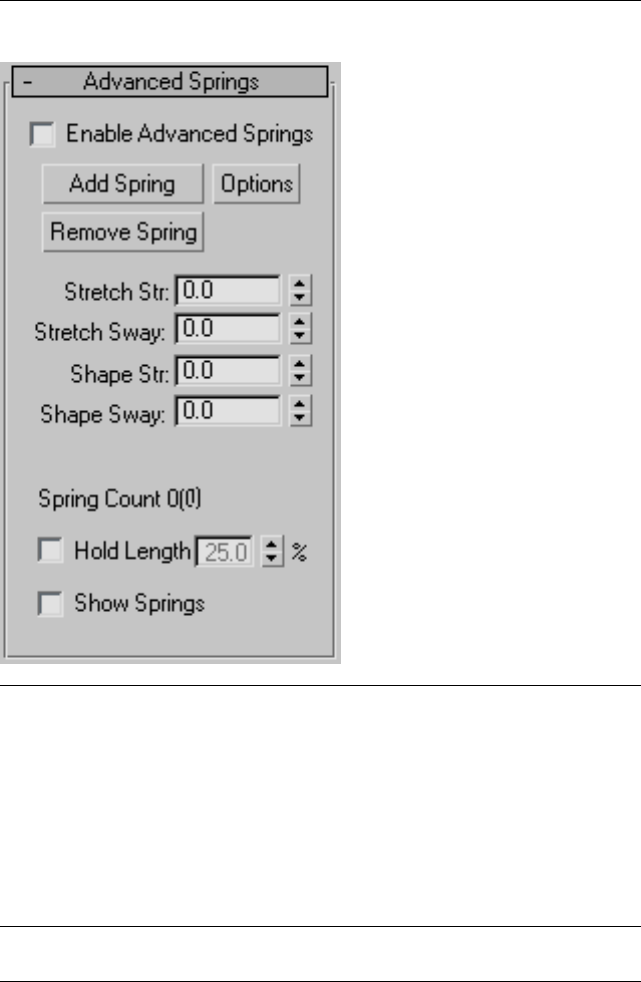
NOTE Additional spring types are available using MAXScript. See the MAXScript
reference for details.
Enable Advanced Springs Makes the numeric controls available for editing,
and disconnects the Strength and Sway settings from the Simple Soft Bodies
controls. Default=off.
The four numeric Stretch and Sway settings in this rollout are available only
when Enable Advanced Springs is on.
Add Spring Adds one or more springs to the object based on the vertex
selection at the Weights & Springs sub-object level and the Spring Option
dialog on page 1418 settings.
NOTE You cannot undo this action. To delete existing springs, select the endpoints
and click Remove Spring.
Flex Modifier | 1417

Options Opens the Spring Option dialog on page 1418 for determining how
springs are added with the Add Spring function.
Remove Spring Deletes any springs that have both vertices selected at the
Weights & Springs sub-object level.
Stretch Str. Determines the strength of the edge springs; the higher the
strength, the less the distance between them can vary.
Stretch Sway Determines the sway of the edge springs; the higher the
strength, the less the angle between them can vary.
Shape Str. Determines the strength of the shape springs; the higher the
strength, the less the distance between them can vary.
Shape Sway Determines the sway of the shape springs; the higher the
strength, the less the angle between them can vary.
Spring Count Displays the number of edge springs, followed by the number
of shape springs in parentheses.
Hold Length Maintains the length of edge springs within the specified
percentage.
NOTE This setting, which is applied after the Flex simulation, can affect the object
shape, and thus cause collision detection to fail.
Show Springs Displays edge springs as blue lines and shape springs as red
lines. Springs are visible only when a Flex sub-object mode is active.
You can change the spring colors using MAXScript.
Spring Option Dialog
Select a Mesh, Patch, or NURBS object. > Modify panel > Modifier List >
Animation Modifiers > Flex > Advanced Springs rollout > Options button
Use the Spring Option dialog to determine how springs are added in the Flex
modifier when you click the Advanced Springs rollout > Add Spring button.
1418 | Chapter 9 Modifiers
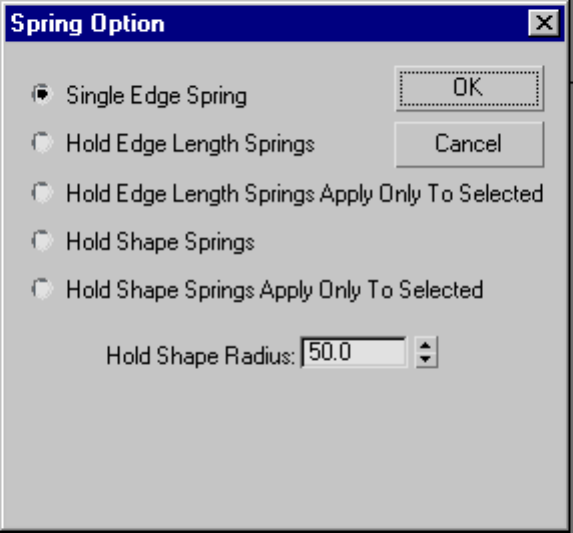
Interface
Single Edge Spring Creates one edge spring between two selected vertices.
If any number of vertices is selected other than two, no springs are created.
Hold Edge Length Springs Creates edge springs along the edges of the objects
between any vertex selection and neighboring vertices.
Hold Edge Length Springs Apply Only To Selected Creates edge springs along
the edges of the objects between all selected vertices.
Hold Shape Springs Creates shape springs from the selected vertex or vertices
to all other vertices within the Hold Shape Radius.
Hold Shape Springs Apply Only To Selected Creates shape springs between
all selected vertices within the Hold Shape Radius.
Hold Shape Radius The radius within which shape springs are created. No
shape springs are created between vertices farther apart than this distance.
Flex Modifier | 1419

At the bottom of the dialog is an informational display showing the object's
average edge length, maximum edge length, and minimum edge length. This
information can help in determining an appropriate Hold Shape Radius setting.
HSDS Modifier
Select an object. > Modify panel > Modifier List > Object-Space Modifiers >
HSDS Modifier
Select an object. > Modifiers menu > Subdivision Surfaces > HSDS Modifier
The HSDS modifier implements Hierarchical SubDivision Surfaces. It is
intended primarily as a finishing tool rather than as a modeling tool. For best
results, perform most of your modeling using low-polygon methods, and then
use HSDS to add detail and adaptively refine the model.
NOTE Better speed optimization has been implemented in the HSDS modifier.
Subdivision calculations are now handled more efficiently making the HSDS
modifier faster.
The modifier's primary features are:
■Local refinement
■Hierarchical modeling
■Adaptive tessellation
With local refinement, you subdivide part of a polygon mesh and edit the
mesh in the subdivided area. This is done indirectly by manipulating
sub-objects in a control grid. Use this feature when you need to increase mesh
resolution in specific areas of a model rather than uniformly over the entire
object, as with the Tessellate modifier on page 1743 . An example of usage would
be a human hand. Once you've modeled the basic shape, you might use the
HSDS modifier to add bumps for the knuckles.
The HSDS modifier supports multiple levels of detail, hence its hierarchical
nature. The Subdivision Stack lets you visually navigate the levels of detail at
any time while using the modifier. Thus, you can edit the same part of a mesh
at different mesh resolutions. If you work at a level of detail lower than the
highest available, the higher-detail areas are still in effect, but you control
them indirectly by means of the more widespread sub-objects at the lower
level.
1420 | Chapter 9 Modifiers
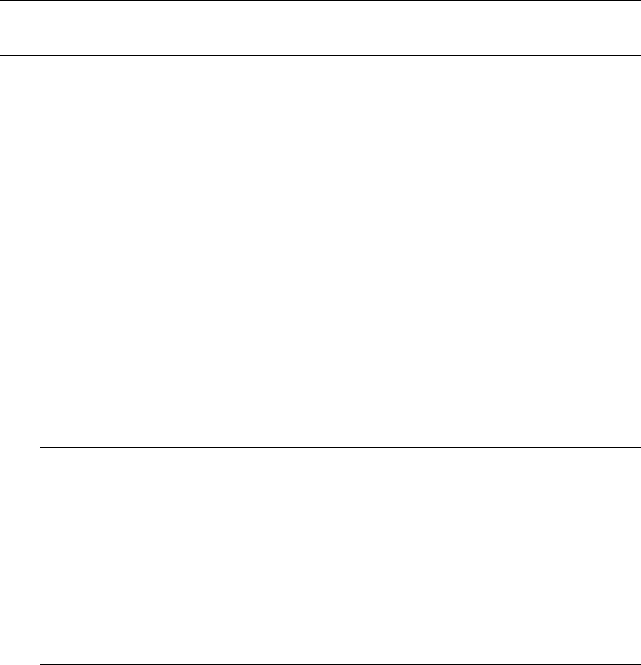
Sub-object animation is supported only at the lowest level of detail: Base Level.
This is accomplished by animating the mesh below the HSDS modifier. To
apply deformation animation after HSDS modeling, first convert the object
to an editable mesh by right-clicking the modifier stack and choosing Collapse
All.
The adaptive tessellation automatically subdivides polygons as needed to
maintain a smoothly curved surface when transforming mesh sub-objects.
You can use a preset or provide custom settings.
IMPORTANT HSDS models are not passed up the modifier stack. The HSDS
modifier takes a polygon mesh as input, and outputs a triangle-based mesh.
Also, The HSDS modifier does not handle changes to the modified object's
topology, such as altering a sphere's Segments setting. Topology changes to
the input mesh results in the loss of all edits made in the HSDS modifier.
Procedures
To use the HSDS modifier:
1Apply the HSDS modifier to an object.
By default, the HSDS modifier doesn't convert non-quadrilateral polygons
to quads. Because the modifier works best with four-sided polygons, it's
recommended you perform the conversion if necessary.
2If the object contains any non-quadrilateral polygons, in the HSDS
Parameters dialog, turn on Force Quads. Click Yes in the Force Quads?
dialog that appears.
NOTE Upon conversion to quads, the modifier automatically performs one
level of subdivision with smoothing (like MeshSmooth on page 1460 with one
iteration) on the object to which it's applied. Thus, for best results, use it with
relatively low-polygon objects. For example, if you usually work with the
Sphere object at the default 32 segments, use a 16-segment sphere with
HSDS.
If the object is made up of quads only, Force Quads isn't available because
no conversion is necessary.
3Choose a sub-object mode at which to subdivide.
The object is covered with a gold control grid (or, in Vertex sub-object
mode, a white grid with blue vertices), indicating that the entire mesh is
available for subdivision and/or sub-object transformation at base level.
HSDS Modifier | 1421
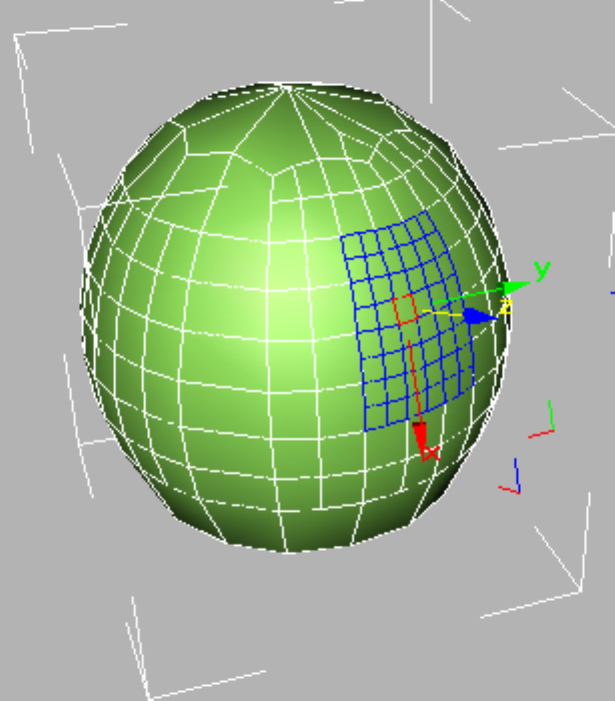
4Select one or more sub-objects.
5Click the Subdivide button.
The modifier again subdivides and smoothes the selected sub-objects as
well as all surrounding polygons. The resultant sub-objects reside at a
higher level of detail, as indicated by the addition of a level in the
Subdivision Stack. Now the control grid shows only polygons at the new
level. With sub-objects other than Element, this typically covers only
part of the object's surface.
A control grid on a sphere at level 2. Subdivisions at lower levels are visible as
gold lines.
1422 | Chapter 9 Modifiers
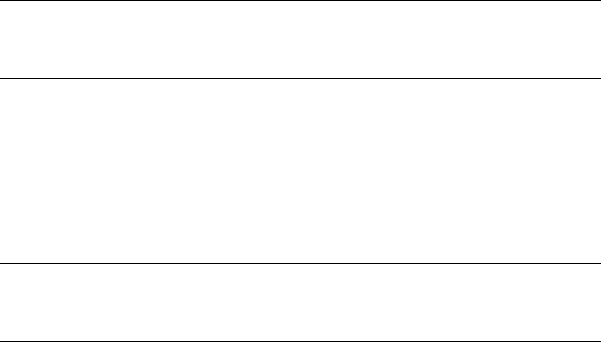
In wireframe views, you can still see polygons at lower levels of detail,
but you can select only sub-objects resulting from the subdivision, as
indicated by the control grid. You can subdivide sub-objects further,
transform them, hide and delete them, and change material IDs.
NOTE When you transform an HSDS sub-object, the control grid tends to
expand by adding segments at its edges, in order to maintain surface
smoothness.
6To subdivide a different part of the object, choose a lower level in the
Subdivision Stack, and then repeat steps 2–4.
Each time you subdivide a sub-object that has been subdivided, a higher
level in the Subdivision Stack is hightlighted, indicating a finer mesh
resolution. You can then work at that level, or any lower level by selecting
the level.
NOTE If you transform a sub-object at a level lower than the highest level in
which the subject exists, the mesh uses the resolution imparted by the detail
in the higher levels.
Interface
HSDS Parameters rollout
The sub-objects available in the HSDS modifier belong to the control grid
rather than the mesh object itself. Transforming the grid sub-objects also
transforms the underlying mesh, but the mesh doesn't always move to the
full extent of the control grid. This is particularly true in cases where you
transform a sub-object at a level lower than the highest level in which the
sub-object resides.
For example, if you subdivide a vertex at the Base Level, it then resides in the
Base Level and Level 1. If you then move the vertex in the base level, the mesh
doesn't, by default, move as far as the vertex. This is roughly analogous to the
way free-form deformation works, but with HSDS, the control grid conforms
much more closely to the shape of the mesh object.
With vertices, you can control the degree to which the mesh follows the
control-grid vertex with the settings on the Vertex Interpolation on page 1425
group.
HSDS Modifier | 1423

Vertex Turns on Vertex sub-object mode, which lets you select a vertex
beneath the cursor; region selection selects vertices within the region.
1424 | Chapter 9 Modifiers

Edge Turns on Edge sub-object mode, which lets you select a face or
polygon edge beneath the cursor; region selection selects multiple edges within
the region.
Polygon Turns on Polygon sub-object mode, which lets you select a
single face or polygon. A polygon is the area you see within the visible wire
edges. Region selection selects multiple polygons within the region.
Element Turns on Element sub-object mode, which lets you select all
contiguous polygons beneath the cursor in the current level of detail.
Ignore Backfacing When on, you can select only those sub-objects whose
normals are visible in the viewport. When off (the default), selection includes
all sub-objects, regardless of the direction of their normals. Default=off.
Only Current Level Displays only polygons at the current level of detail, with
highlights, but without smoothing. Use this option to speed up the display
when working with complex objects. Default=off.
Subdivision Stack Shows the current level of the subdivision hierarchy.
Automatically increments when you subdivide a sub-object selection. To edit
at a different level of detail, select the level in the stack. The current level is
outlined in red.
■Visibility is controlled by the box icon to the right of the level label.
Turning on the visibility at one level activates the visibility from that level
down to the base level. Visibility above that level will be turned off.
Subdivide Performs subdivision and smoothing on the current selection,
and adds a level to the Subdivision Stack. When the subdivision results in a
control grid and other subdivisions have been performed at the same level of
detail, the control grids may become interconnected.
Vertex Interpolation group
HSDS Modifier | 1425
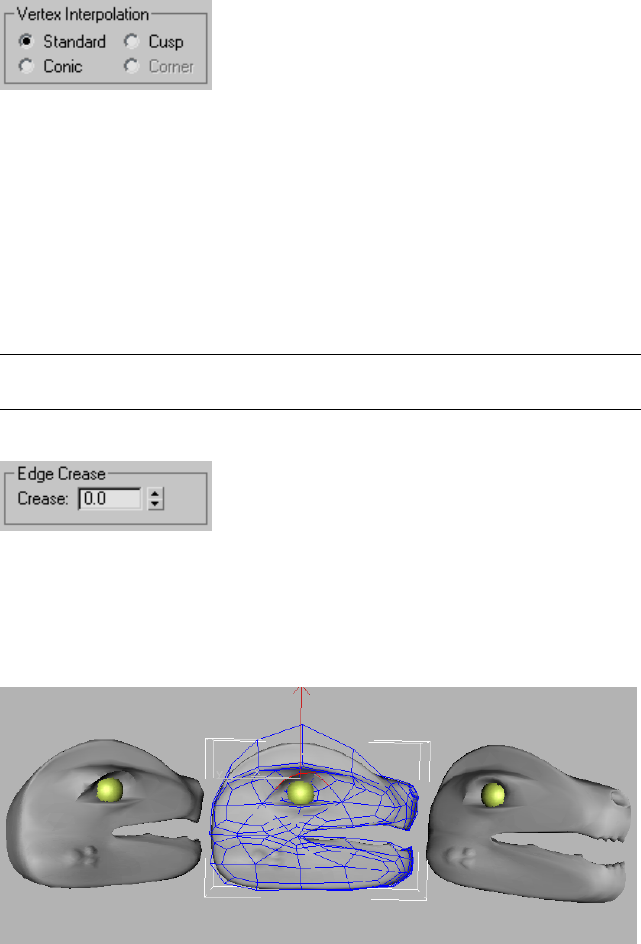
Determines how selected vertices are treated during subdivision. Available
only in Vertex sub-object mode.
For best results, use when moving control grid vertices at a level of detail lower
than the highest in which the vertex resides.
Standard/Conic/Cusp/Corner Determines how closely mesh vertices follow
the movement of control grid vertices. Standard provides the least amount of
relative movement, while Cusp and Corner provide the most. Corner also
keeps edges adjacent to subdivided vertices from being rounded off during
subdivision. Default=Standard.
NOTE Corner is available only when the selected vertex or vertices aren't
surrounded by polygons, such as the vertices on the edge of a plane object.
Edge Crease group
Determines the extent to which selected edges are treated as creases during
subdivision. Available only in Edge sub-object mode.
For best results, use with control grid edges at a level of detail lower than the
highest in which the edge resides. Also, for creasing to be visible, the edge
should be offset from the surrounding surface by a significant amount.
Left: Crease=1.0
Center: The eyebrow edges selected at LOD 0
1426 | Chapter 9 Modifiers

Right: Crease=0.0
Crease Specifies how much creasing is performed on the selected edge or
edges. At low settings, the edge is relatively smooth. At higher settings, the
crease becomes increasingly visible. At 1.0, the highest setting, the edge is not
smoothed at all. Default=0.0. Range=0.0 to 1.0.
Advanced Options rollout
Force Quads When on, the modifier converts all non-quadrilateral faces or
polygons to four-sided polygons. When off, converts all polygons to triangles.
Available only when the object contains any non-quadrilateral faces or
polygons. Default=off.
When you change the status of Force Quads, any edits made in the HSDS
modifier are lost. A message appears warning you of this, and asking you to
confirm the change.
Because the modifier works best with four-sided polygons, it's recommended
you confirm the conversion if an object contains non-quadrilateral faces or
polygons. The sphere primitive is an example of such an object; the uppermost
and lowermost faces are three-sided.
Smooth Result When turned on, all faces on the object will be in smoothing
group 1, but if Smooth Result is turned off, each face will inherit smoothing
groups from the input MNMesh.
Material ID Displays the material ID assigned to the current selection.
Available only in Polygon and Element sub-object modes. If multiple
sub-objects are selected and they don't share an ID, this field is blank.
You can change the material ID assigned to selected sub-objects at the current
and higher levels of detail by changing this setting.
Material IDs are used primarily with Multi/Sub-Object material on page 5558 .
Hide Hides the current polygon selection. Available only at the Polygon and
Element sub-object levels. Use Unhide All to reveal hidden polygons.
TIP Use Hide to isolate part of an object you want to work on. The Select Invert
command on the Edit menu is useful in this case. Select the faces you want to
focus on, choose Edit > Select Invert, then click the Hide button.
Unhide All Reveals hidden polygons.
Delete Polygon Deletes the current polygon selection, creating a hole or
holes in the surface. Available only in Polygon sub-object mode.
HSDS Modifier | 1427

NOTE When the current level of detail does not encompass the entire object
surface, you cannot delete polygons at the border of the control grid; that is,
polygons that do not share all edges with other polygons in the grid.
Adaptive Subdivision Opens the Adaptive Subdivision dialog on page 1428 .
This option is best used for smoothing subdivided and edited portions of the
mesh when you're finished using the HSDS functionality.
Soft Selection rollout
These controls let you set a gradual falloff of influence between selected and
unselected vertices. See Soft Selection Rollout (Edit/Editable Mesh) on page
1926 .
Adaptive Subdivision Dialog
Select an object. > Modify panel > Modifier List > Object-Space Modifiers >
HSDS Modifier > HSDS Parameters rollout > Adaptive Subdivision button
Select an object. > Modifiers menu > Subdivision Surfaces > HSDS Modifier >
HSDS Parameters rollout > Adaptive Subdivision button
Use adaptive subdivision for smoothing subdivided and edited portions of
the mesh when you're finished using the HSDS modifier on page 1420 .
Alternatively, you can use adaptive subdivision to remove a level of detail
from the object.
Procedures
To use adaptive subdivision:
1Edit an object with the HSDS modifier.
2Choose Add Detail or Remove Detail, depending which operation you
want to perform.
3Set the desired amount of detail with one of the presets or by specifying
custom Length and Angle settings.
4Click OK to perform the specified operation.
The detail addition or removal is performed, and you're returned to the
HSDS modifier. Depending on whether you removed or added detail, the
highest level of detail is decremented or incremented by 1.
1428 | Chapter 9 Modifiers
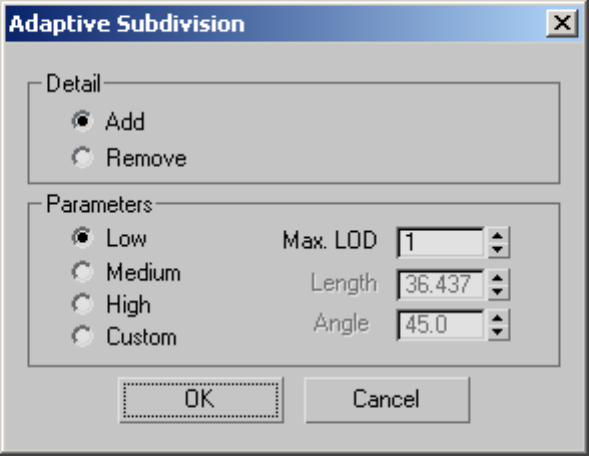
Interface
Detail group
Add/Remove Determines whether clicking the OK button increases or
decreases detail.
Parameters group
These settings determine the extent to which detail is added or removed. The
Length and Angle settings are available for editing only when the Custom
option is chosen. However, they show the default settings for the Low,
Medium, and High options.
Low/Medium/High/Custom Choose one of the presets, or choose Custom
to set your own Length and Angle values.
Max. LOD Specifies the highest number of levels of detail that the software
can add when increasing detail. Not available when removing detail.
Length The maximum permissible length of any edge after adding or
removing detail. The smaller the length, the higher the amount of tessellation
that is allowed.
HSDS Modifier | 1429
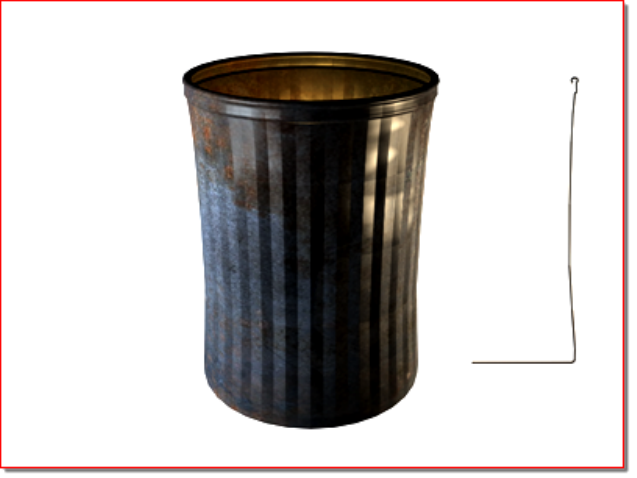
Angle The maximum permissible angle between two opposite edges
emanating from a vertex. The smaller the angle, the higher the amount of
tessellation that is allowed.
OK Performs the subdivision or removal of detail and closes the dialog.
Cancel Closes the dialog without changing the mesh.
Lathe Modifier
Select a shape. > Modify panel > Modifier List > Lathe
Select a shape. > Modifiers menu > Patch/Spline Editing > Lathe
Lathe creates a 3D object by rotating a shape or NURBS curve about an axis.
Object resulting from 360-degree lathe
1430 | Chapter 9 Modifiers

Interface
Modifier Stack
Axis At this sub-object level, you can transform and animate the axis of
revolution.
For more information on the stack display, see Modifier Stack on page 7427 .
Lathe Modifier | 1431
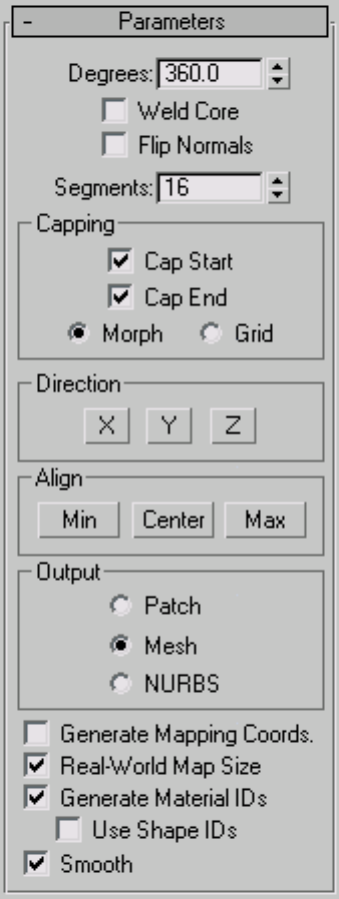
Parameters rollout
Degrees Determines the number of degrees that the object is spun around
the axis of revolution (0 to 360, default=360). You can set keyframes for Degrees
1432 | Chapter 9 Modifiers
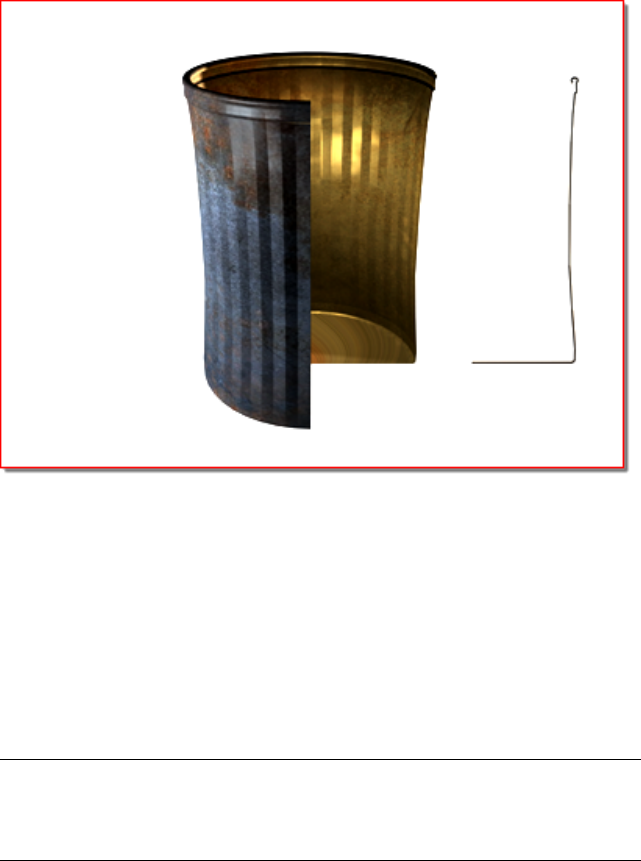
to animate the circular growth of a lathed object. The Lathe axis auto-sizes
itself to the height of the shape being lathed.
Object resulting from 270-degree lathe
Weld Core Simplifies the mesh by welding together vertices that lie on the
axis of revolution. Keep it turned off if you intend to create morph targets.
Flip Normals Depending on the direction of the vertices on your shape, and
the direction of rotation, the lathed object might be inside out. Toggle the
Flip Normals check box to fix this.
Segments Determines how many interpolated segments are created in the
surface between the start and endpoint. This parameter is also animatable.
Default=16
NOTE You can create up to 10,000 segments using the segments spinner. Try
not to create geometry that is more complex than you need. Often you can get
satisfactory results by using smoothing groups or smoothing modifiers, rather than
increasing segmentation.
Lathe Modifier | 1433
Capping group
Controls whether or not caps are created for the interior of the lathed object
if Degrees is set to less than 360.
Cap Start Caps the start of the lathed object with Degrees set to less than
360 and a closed shape.
Cap End Caps the end of the lathed object with Degrees set to less than 360
and a closed shape.
Morph Arranges cap faces in a predictable, repeatable pattern necessary for
creating morph targets. Morph capping can generate long, thin faces that
don't render or deform as well as grid capping. Use morph capping primarily
if you are lathing multiple morph targets.
Grid Arranges cap faces in a square grid trimmed at the shape boundaries.
This method produces a surface of evenly sized faces that can easily be
deformed by other modifiers.
Direction group
Sets up the direction of the axis of revolution, relative to the pivot point of
the object.
X/Y/Z Set the direction of the axis of revolution relative to the pivot point
of the object.
Align group
Min/Center/Max Align the axis of revolution to the minimum, center, or
maximum extents of the shape.
Output group
Patch Produces an object that you can collapse to a patch object (see Editing
the Stack on page 1023 ).
Mesh Produces an object that you can collapse to a mesh object (see Editing
the Stack on page 1023 ).
NURBS Produces an object that can be collapsed to a NURBS surface (see
Editing the Stack on page 1023 ).
Generate Mapping Coordinates Applies mapping coordinates to the lathed
object. When Degrees is less than 360, and Generate Mapping Coordinates is
1434 | Chapter 9 Modifiers
turned on, additional mapping coordinates are applied to the end caps, placing
a 1 x 1 tile on each cap.
Real-World Map Size Controls the scaling method used for texture mapped
materials that are applied to the object. The scaling values are controlled by
the Use Real-World Scale settings found in the applied material's Coordinates
rollout on page 5620 . Default=on.
Generate Material IDs Assigns different material IDs to the sides and the
caps of the lathed object. Specifically, the sides receive ID 3, and the caps
(when Degrees is less than 360 and the lathed shape is closed) receive IDs 1
and 2. Default=on.
Use Shape IDs Uses the material ID values assigned to segments in the spline
on page 542 you lathed, or curve sub-objects in the NURBS on page 2152 curve
you lathed. Use Shape IDs is available only when Generate Material IDs is
turned on.
Smooth Applies smoothing to the lathed shape.
Lattice Modifier
Select an object or a shape. > Modify panel > Modifier List > Object-Space
Modifiers > Lattice
Select an object or a shape. > Modifiers menu > Parametric Deformers > Lattice
The Lattice modifier converts the segments or edges of a shape or object into
cylindrical struts with optional joint polyhedra at the vertices. Use this either
to create renderable structural geometry based on the mesh topology, or as
an alternate method to achieve a rendered wireframe effect.
Lattice Modifier | 1435
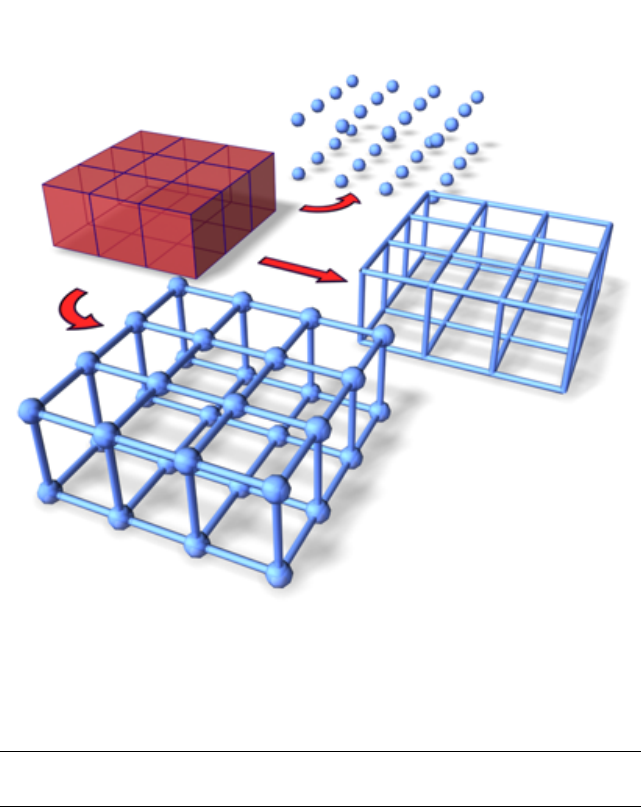
Top: Joints only
Middle: Struts only
Bottom: Both (joints and struts)
NOTE This modifier can act on the whole object or on sub-object selections in
the stack.
1436 | Chapter 9 Modifiers
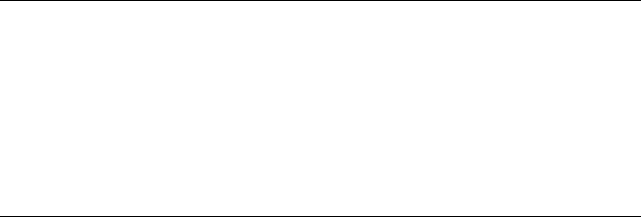
TIP You can combine the Scatter compound object on page 647 with the Lattice
modifier to place any object you want as a joint, rather than the provided
polyhedra. To do this, create your mesh distribution object and your source object
(for example, a box). Use Scatter to scatter the box at the vertices of the distribution
object. (Be sure to use the Copy option rather than Instance.) In the Scatter Display
parameters, hide the distribution object. Select the original object that was used
as a distribution object, apply Lattice to it, and turn off the joints. You'll have two
coincident objects: one providing the lattice struts, and the other positioning the
boxes.
Lattice Modifier | 1437

Interface
Geometry group
Specifies whether to use the whole object or selected sub-objects, and which
of the two components (struts and joints) is displayed.
1438 | Chapter 9 Modifiers
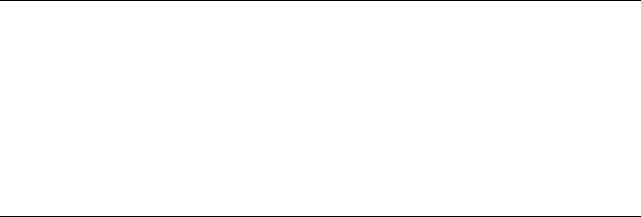
Apply To Entire Object Applies Lattice to all edges or segments in the object.
When turned off, applies Lattice only to selected sub-objects passed up the
stack. Default=on.
NOTE When Apply To Entire Object is turned off, unselected sub-objects render
normally. For example, if you convert a box to an editable mesh, select one
polygon, and then apply Lattice with Apply To Entire Object turned off, the face
does not render, while the edges and vertices that form that face are converted
to struts and joints, and the remaining faces render normally. However, if you
select the four edges surrounding the polygon and turn off Ignore Hidden Edges,
the struts and joints are added to the object while all faces render as normal. If
you turn on Struts group > Ignore Hidden Edges, one of the polygon's faces renders,
while the other doesn't.
Joints Only From Vertices Displays only the joints (polyhedra) generated by
the vertices of the original mesh.
Struts Only From Edges Displays only the struts (cylinders) generated by the
segments of the original mesh.
Both Displays both struts and joints.
Struts group
Provides controls that affect the geometry of the struts.
Radius Specifies the radius of the struts.
Segments Specifies the number of segments along the struts. Increase this
value when you need to deform or distort the struts with subsequent modifiers.
Sides Specifies the number of sides around the perimeter of the struts.
Material ID Specifies the material ID to be used for the struts. The struts and
the joints can have different material IDs, making it easy to assign them
different materials. The struts default to ID #1.
Ignore Hidden Edges Generates struts only for visible edges. When turned
off, generates struts for all edges, including the invisible edges. Default=on.
End Caps Applies end caps to the struts.
Smooth Applies smoothing to the struts.
Joints group
Provides controls that affect the geometry of the joints.
Lattice Modifier | 1439
Geodesic Base Type Specifies the type of polyhedron used for the joints.
Tetra Uses a tetrahedron.
Octa Uses an octahedron.
Icosa Uses an icosahedron.
Radius Specifies the radius of the joints.
Segments Specifies the number of segments in the joints. The more segments,
the more spherical the joints' shape.
Material ID Specifies the material ID to be used for the joints. Defaults to ID
#2.
Smooth Applies smoothing to the joints.
Mapping Coordinates group
Determines the type of mapping assigned to the object.
None Assigns no mapping.
Reuse Existing Uses the mapping currently assigned to the object. This might
be the mapping assigned by Generate Mapping Coords., in the creation
parameters, or by a previously assigned mapping modifier. When using this
option, each joint inherits the mapping of the vertex it surrounds.
New Uses mapping designed for the Lattice modifier. Applies cylindrical
mapping to each strut, and spherical mapping to each joint.
Linked XForm Modifier
Modify panel > Select objects or sub-objects. > Modifier List > Object-Space
Modifiers > Linked XForm
Select an object or sub-objects. > Modifiers menu > Animation Modifiers >
Linked XForm
The Linked XForm modifier links the transforms for any object or sub-object
selection to another object, called the control object. The control object's
motion, rotation, and/or scale transforms are passed onto the object or
sub-object selection.
1440 | Chapter 9 Modifiers
Using Linked XForm
Linked XForm connects any geometry it receives from the stack to another
object, which is called the control object. Its single control simply picks the
control object. To use this modifier, you must have at least two objects in
your scene.
See also:
■XForm Modifier on page 1922
Procedures
To apply a Linked XForm modifier:
1Choose a location in an object's stack and apply a Linked XForm from
the Modifier List.
2On the Parameter's rollout, click Pick Control Object. When animating,
do this at frame 0.
3Select the object you want to be the control object.
This completes the link. The name of the control object appears on the
Parameters rollout.
To apply a Linked XForm modifier at a Sub-Object level:
1Choose an Editable Mesh or an object to which a Mesh Select modifier
has been applied.
2Turn on the Vertex sub-object level and select some vertices on the object.
3Apply a Linked XForm modifier.
4On the Parameter's rollout, click Pick Control Object. When animating,
do this at frame 0.
5Select another object that you want to control the sub-object selection.
This completes the link. The name of the control object appears on the
Parameters rollout.
6Move the control object and see how the vertices are affected.
Linked XForm Modifier | 1441
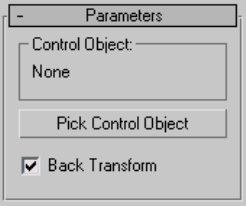
Interface
Control Object Object that the vertices are linked to. When transformed,
the vertices follow.
Pick Control Object Click this button, and then select the object that you
want to be the control object.
Back Transform Allows an object with a Linked XForm modifier to be linked
to a Control Object. Normally, moving the Control Object causes the linked
object to move twice as much as it should, once with the Control Object and
once with the link. When the switch is turned on, any transforms to the
Control Object are only applied to the linked object once. This switch is similar
to the 'Back Transform Vertices' switch of the Skin on page 1600 modifier.
LS Mesh Modifier
Select a Lightscape mesh object. > Modify panel > Modifier List > LS Mesh
The LS Mesh modifier refines a Lightscape mesh object.
When a Lightscape scene is imported into 3ds Max, the mesh produced by
Lightscape doesn’t contain the refinements that Lightscape introduced to
improve the lighting. This information is kept and used by the Lightscape
material on page 5579 while rendering. This modifier will add these refinements
to the Lightscape mesh. In conjunction with the LS Colors modifier on page
1118 , this modifier can be used to produce meshes suitable for game engines.
The refinement stored in a Lightscape mesh is hierarchical. When a polygon
is refined, it is broken into four smaller polygons. These polygons can then
be refined further. A polygon in the refinement has a depth from the original
polygon, which is the number of refinements needed to get from the original
polygon to the polygon in question.
1442 | Chapter 9 Modifiers
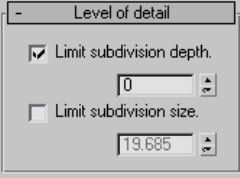
The modifier allows you to reduce the number of polygons in the result by
limiting the depth to which the modifier will descend, or by limiting the size
of polygons that will be refined.
You can apply the LS Mesh modifier to a Face sub-object selection of a
Lightscape mesh object. In this case, only the selected faces will be refined.
Interface
Limit subdivision depth When the toggle is on, the value sets the maximum
depth of refinement. When the toggle is off, then the mesh modifier will
descend to the bottom of the refinement. Default=on, 0.
Limit subdivision size When the toggle is on, the value limits the size of
polygons that are refined. When the toggle is off, then the mesh modifier will
refine polygons to any size. The size is a length in the current view units.
Polygons smaller than that size squared will not be refined by the modifier.
Default=off, 19.685 units or 0.5 meters.
MapScaler Modifier (Object Space)
Select an object. > Modify panel > Modifier List > Object-Space Modifiers >
MapScaler
The MapScaler (OSM) modifier works in object space to maintain the scale of
a map applied to an object. This lets you resize the object via its creation
parameters without altering the scale of the map. Typically, you might use
this to maintain the size of a map regardless of how the geometry is scaled, if
you change the object size by adjusting its creation parameters. However, if
you use a Select And Scale tool to change the object size, the map scales along
with the object.
To maintain the scale of the map regardless of how the object is resized, use
the MapScaler (WSM) modifier on page 1120 .
MapScaler Modifier (Object Space) | 1443
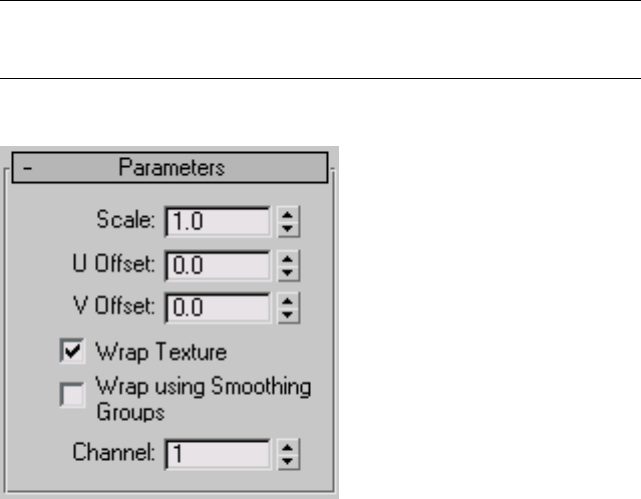
For example, if you scale a brick wall with the MapScaler (WSM) modifier
applied, the bricks will all remain the same size as you increase the size of the
wall. However, if you scale the same wall with the MapScaler (OSM) modifier
applied, the size of the bricks will grow in proportion with the scale of the
wall.
The MapScaler (OSM) modifier has two primary benefits compared to the
WSM version:
■As an object-space modifier, it can reside anywhere in the stack and be
collapsed with the stack, rather than being restricted to the top of the
stack, as with world-space modifiers. This lets other object-space modifiers
take effect after the map-scaling operation.
■When instanced among multiple objects, the object-space version appears
in the modifier stack display when any number of objects is selected. This
differs from the world-space version, which, when instanced among
multiple objects, appears in the stack display only when a single object is
selected.
TIP MapScaler also works at the sub-object level. If the object you're working on
requires different scaling of the texture map on each surface, you can do so by
creating a modifier stack with multiple occurrences of the MapScaler modifier.
Interface
1444 | Chapter 9 Modifiers

Scale Represents the size of one repetition of the texture pattern. Size is
measured in current scene units. Repetitions occur across the object in the U
and V directions. Default=1.0.
NOTE When the Use Real-World Texture Coordinates switch is active in the
General Preferences dialog on page 7536 , the scale setting defaults to 1.0. If Use
Real-World Texture Coordinates is turned off, scale defaults to 100.0.
U/V Offset Specify horizontal and vertical offsets respectively. Available only
when Wrap Texture is off.
Wrap Texture When on, Map Scaler attempts to wrap the texture evenly
around the object. This option requires more computing, but usually produces
the most satisfactory results. Default=on.
Wrap Using Smoothing Groups When turned on, textures are wrapped
around corners when they share the same smoothing groups. Curved walls
will map smoothly while sharp corners get a new texture origin. This switch
is only available when the Wrap Textures switch is turned on. Default=off.
Channel Specifies the map channel on page 7836 . Default=1.
Material Modifier
Select an object. > Modify panel > Modifier List > Object-Space Modifiers >
Material
Select an object. > Modifiers menu > Surface > Material
Select an object. > Modifiers tab > Material Modifier
The Material modifier allows you to animate, or simply change, the assignment
of material IDs on page 7842 on an object. If the material ID is animated, the
change to a new material ID is abrupt, from one frame to the next.
Material Modifier | 1445
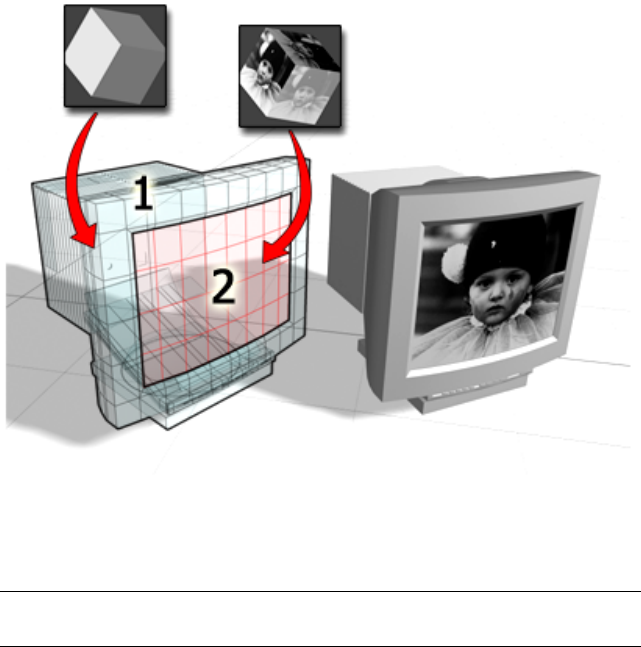
Object mapped using a multi/sub-object material:
Material ID 1 for the housing of the monitor
Material ID 2 for the image on the screen
TIP If you want a gradual blend from one material to another, try animating the
Mix parameter on a Blend on page 5546 material.
Use this modifier in conjunction with the multi/sub-object on page 5558
material type, to assign different materials to objects or faces at different frames
of an animation, or to quickly change the material ID of an object.
See also:
■Editable Mesh Surface on page 1990
Patches
As of 3ds Max 4, patch objects coming up the modifier stack are not converted
to a mesh by this modifier. A patch object input to the Material modifier
retains its patch definition. Files that contain patch objects with the Material
1446 | Chapter 9 Modifiers
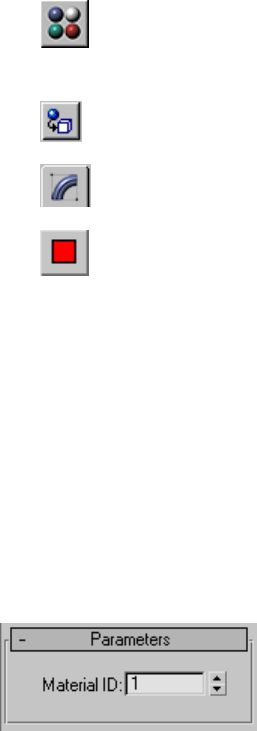
modifier from previous versions of the software will be converted to meshes
to maintain backward compatibility.
Procedures
Example: To change the material ID of a sub-object selection:
1In the Top viewport, create a sphere.
2 In the Material Editor, create a multi/sub-object material.
Make the colors of material ID 1 and 2 different.
3 Assign the multi/sub-object material to the sphere.
4 On the Modify panel, choose Mesh Select from the Modifier List.
5 On the Mesh Select Parameters rollout, click Polygon.
6In the Front viewport, region-select the lower half of the sphere.
The selected polygons turn red.
7While Polygon is still the active sub-object level (in the stack display, a
square polygon icon appears to the right of Mesh Select), choose Material
from the Modifier List.
8On the Material modifier Parameters rollout, set the value of the Material
ID to 1 and 2 to toggle the color on and off.
In the shaded viewport, the lower half of the sphere changes to the color
of the selected material ID.
Interface
Material ID Sets the material ID to be assigned; this can be animated. If the
input object is in face sub-selection, then the ID is only applied to selected
Material Modifier | 1447
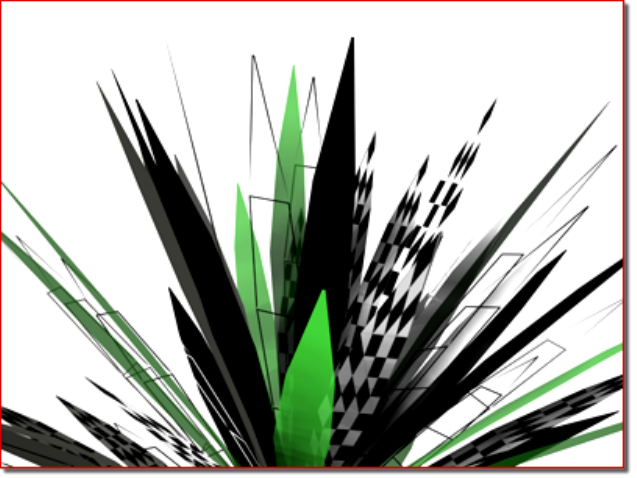
faces; otherwise, it is applied to the entire object. The ID number refers to one
of the materials in a multi/sub-object material.
MaterialByElement Modifier
Modify panel > Make a selection. > Modifier List > Object-Space Modifiers >
MaterialByElement
Make a selection. > Modifiers menu > Surface > Material By Element
The MaterialByElement modifier lets you apply different material IDs to objects
containing multiple elements, at random or according to a formula. When
animated, this effect is useful for such applications as an office building at
night with window illumination turning on and off at random.
Various materials randomly applied to the leaves of the plant
Procedures
Example: To assign colors randomly in a group of spheres:
1Create six spheres.
1448 | Chapter 9 Modifiers

TIP One method is to add a sphere on page 356 primitive, then use Shift+
Move on page 888 with the Copy option, and enter 5 in the Number Of
Copies field.
2Combine the spheres into a single editable mesh object.
Right-click a selected sphere and from the Transform (lower-right)
quadrant of the quad menu, choose Convert To: > Convert to Editable
Mesh. Then click Modify panel > Edit Geometry rollout > Attach List. In
the Attach List dialog, click All, and then Attach.
3Create a multi/sub-object material on page 5558 with six materials, and
specify a different color for each material. Assign the material to the object
with multiple spheres.
Because sphere primitives are assigned material ID 2 by default, all the
spheres now have the color assigned to material number 2 in the
multi/sub-object material.
4Assign the MaterialByElement modifier to the object.
5From the Parameters rollout, turn on Random Distribution.
Because the default ID Count setting is 2, some of the spheres are assigned
sub-material #1, and the rest are assigned #2.
6Use the spinner to increase the ID Count setting to 3. Also change the
Uniqueness group > Seed value.
Now the first three materials are assigned to the spheres at random,
although with some Seed settings, you may see only two different colors.
7Keep increasing the ID Count setting until you see all six colors in the
multi/sub-object material. As the assignments are random, it may take
awhile.
MaterialByElement Modifier | 1449
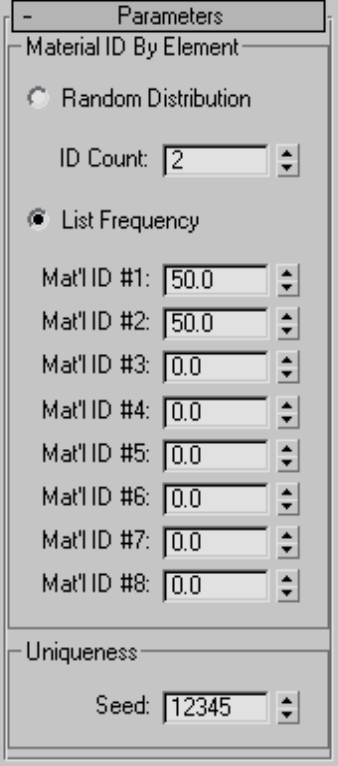
Interface
Material ID By Element group
The two choices in this group let you either create a truly random distribution
of material IDs or divide the assignments among up to eight materials
according to percentages you set.
Random Distribution Assigns the materials at random to different elements
in the object.
1450 | Chapter 9 Modifiers

ID Count Determines the minimum number of material IDs to assign. Because
material ID assignment is random, setting it to the number of materials in the
multi/sub-object material or higher doesn't guarantee that all materials get
used.
List Frequency Determines an approximate relative weight (percentage) for
each of up to eight material IDs, as set by the Mat'l ID #1-8 spinners. The
modifier assigns material IDs until the weights total 100.
For example, if you set Mat'l ID #1 to 40, #2 to 35, and #3 to 60, approximately
40 percent of the elements will be assigned material ID 1, 30 percent will be
assigned material ID 2, and 25 percent (100 − [40 + 35]) will be assigned
material ID 3. Any remaining percentages (as set in Mat'l IDs 4-8) are ignored.
NOTE These percentages are approximate. The more elements the object contains,
the closer the assigned percentage comes to the set percentage.
Uniqueness group
Seed Sets the seed value for the (pseudo-)randomization of material ID
assignments. Not animatable.
Melt Modifier
Modify panel > Make a selection. > Modifier List > Melt
Make a selection. > Modifiers menu > Animation Modifiers > Melt
Melt Modifier | 1451
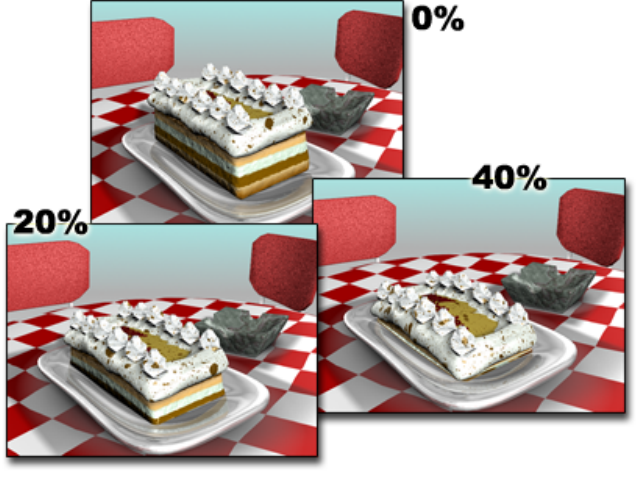
Increasing the Melt amount progressively melts the cake
The Melt modifier lets you apply a realistic melting effect to all types of objects,
including editable patches and NURBS objects, as well as to sub-object
selections passed up the stack. Options include sagging of edges, spreading
while melting, and a customizable set of substances ranging from a firm plastic
surface to a jelly type that collapses in on itself.
Procedures
Example: To animate a jelly-like melting sphere:
1In the Top viewport, create a Sphere primitive with a radius of about 50
units.
2Apply the Melt modifier.
3Turn on the Auto Key button and go to frame 100.
4In the Melt group box, set Amount to 70.
5In the Solidity group box, choose Jelly.
6Turn off the Auto Key button.
1452 | Chapter 9 Modifiers
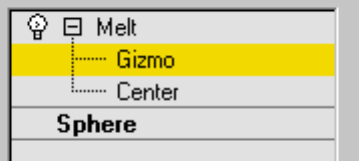
7Drag the time slider to see the sphere melt.
Interface
Modifier Stack
Gizmo At this sub-object level, you can transform and animate the gizmo
like any other object, altering the effect of the Melt modifier. Translating the
gizmo translates its center an equal distance. Rotating and scaling the gizmo
takes place with respect to its center.
Center At this sub-object level, you can translate and animate the center,
altering the Melt gizmo's shape, and thus the shape of the melted object.
For more information on the stack display, see Modifier Stack on page 7427 .
Melt Modifier | 1453
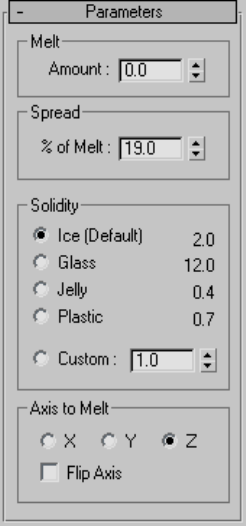
Parameters rollout
Melt group
Amount Specifies the extent of the "decay," or melting effect applied to the
gizmo, thus affecting the object. Range=0.0 to 1000.0.
Spread group
% of Melt Specifies how much the object and melt will spread as the Amount
value increases. It's basically a "bulge" along a flat plane.
Solidity group
Determines the relative height of the center of the melted object. Less-solid
substances like jelly tend to settle more in the center as they melt. This group
provides several presets for different types of substances, as well as a Custom
spinner for setting your own solidity.
Ice The default Solidity setting.
1454 | Chapter 9 Modifiers
Glass Uses a high Solidity setting to simulate glass.
Jelly Causes a significant drooping effect in the center.
Plastic Relatively solid, but droops slightly in the center as it melts.
Custom Sets any solidity between 0.2 and 30.0.
Axis to Melt group
X/Y/Z Choose the axis (local to the object) on which the melt will occur.
Note that this axis is local to the Melt gizmo and not related to the selected
entity. By default, the Melt gizmo's axes are lined up with the object's local
coordinates, but you can change this by rotating the gizmo.
Flip Axis Normally, the melt occurs from the positive direction toward the
negative along a given axis. Turn on Flip Axis to reverse this direction.
Mesh Select Modifier
Create or select and object > Modify panel > Modifier List > Mesh Select
Make a selection. > Modifiers menu > Selection Modifiers > Mesh Select
The Mesh Select modifier lets you pass a sub-object selection up the stack to
subsequent modifiers. It provides a superset of the selection functions available
in the Edit Mesh modifier on page 1283 . You can select vertices, edges, faces,
polygons or elements, and you can change the selection from sub-object level
to object level.
Note the following:
■When you apply the Mesh Select modifier and then go to any sub-object
level, the select-and-transform buttons in the toolbar are unavailable, and
the Select Object button is automatically activated.
■The Mesh Select modifier automatically turns off the Show End Result
button, which becomes "spring loaded" while you're in the modifier.
For more information on the stack display, see Modifier Stack on page 7427 .
Using XForm Modifiers to Animate a Mesh Selection
When you apply a Mesh Select modifier, there are no animation controllers
assigned to the sub-object selection. This means that the selection has no way
to "carry" the transform information needed for animation.
Mesh Select Modifier | 1455

To animate a sub-object selection using Mesh Select, apply either an XForm
or Linked XForm modifier to the selection. These modifiers provide the
necessary controllers for animating the effects of transforms. In a sense, they
give "whole-object status" to the sub-object selection.
■XForm on page 1922
Animates transforms directly on a sub-object selection. Creates a gizmo
and center for the sub-object selection. You can animate both, with the
center acting as a pivot point for the selection.
■Linked XForm on page 1440
Lets you choose another object to control the animation. The sub-object
selection is linked to the "control object." When you transform the control
object, the sub-object selection follows accordingly.
Procedures
To use the Mesh Select modifier:
1Create a mesh object.
2Select a mesh object.
3Apply a Mesh Select modifier.
4Select vertices, edges, faces, polygons or elements.
5Add another modifier to affect only the selection from step 3.
Interface
Modifier Stack controls
Show End Result Normally, if you apply a modifier such as Twist to
an editable-mesh object and then return to the Editable Mesh stack entry, you
cannot see the effect of the modifier on the object's geometry. But if you turn
on Show End Result, you can see the final object as a white mesh, and the
original editable mesh as an orange mesh.
1456 | Chapter 9 Modifiers
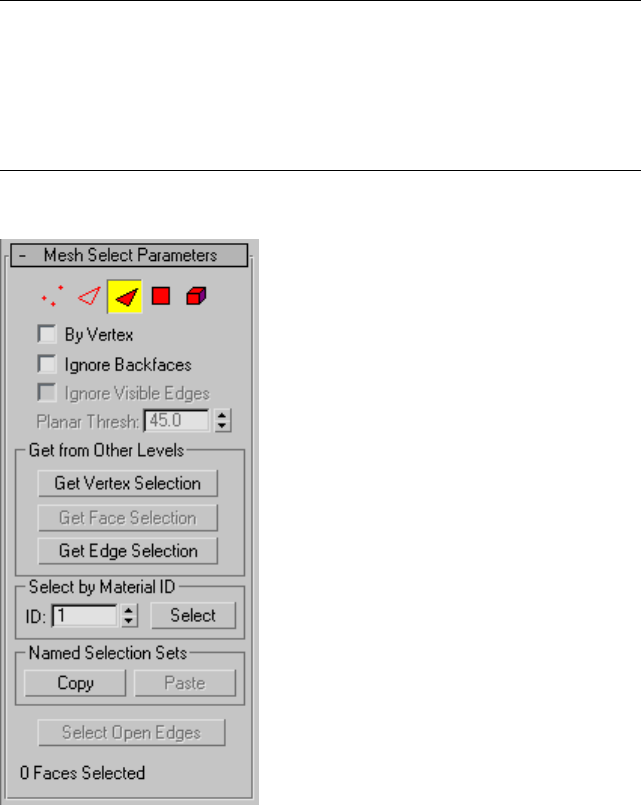
NOTE With modifiers such as MeshSmooth, which apply by default to an entire
object, no special treatment is necessary. However, if you intend to use this
functionality with other modifiers that work on a sub-object selection passed up
the stack, such as Bend, and you want to apply the modifier to the entire object,
you should place a Volume Select modifier on page 1910 between the editable
mesh object and the modifier in the stack. You should leave the Volume Select
modifier's level at the top (the default: no sub-object level chosen).
Mesh Select Parameters rollout
Provides buttons for turning different sub-object modes on and off, working
with named selections and handles, display settings, and information about
selected entities.
The icons at the top of the Selection rollout let you specify the method of
sub-object selection.
Mesh Select Modifier | 1457
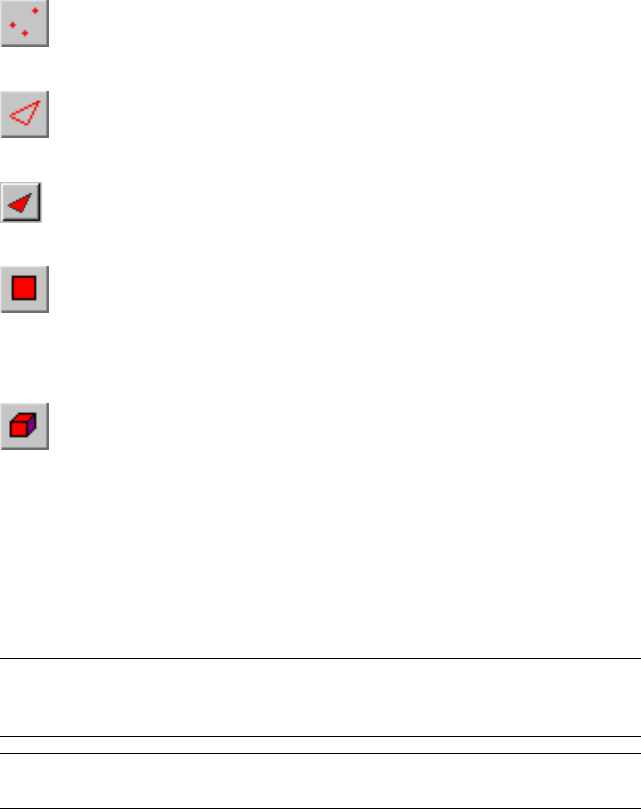
Clicking a button here is the same as selecting a sub-object level in the modifier
stack. Click the button again to turn it off and return to the object selection
level.
Vertex Selects a vertex beneath the cursor; region selection selects
vertices within the region.
Edge Selects a face or polygon edge beneath the cursor; region selection
selects multiple edges within the region.
Face Selects a triangular face beneath the cursor; region selection selects
multiple triangular faces within the region.
Polygon Selects all coplanar faces (defined by the value in the Planar
Threshold spinner) beneath the cursor. Usually, a polygon is the area you see
within the visible wire edges. Region selection selects multiple polygons within
the region.
Element Selects all contiguous faces in an object. Region selection
selects the same.
By Vertex Selects any sub-objects at the current level that use a vertex you
click. Applies to all sub-object levels except Vertex. Also works with Region
Select.
Ignore Backfaces Selects only those sub-objects whose normals make them
visible in the viewport. When turned off (the default), selection includes all
sub-objects, regardless of the direction of their normals.
NOTE The state of the Backface Cull setting in the Display panel doesn't affect
sub-object selection. Thus, if Ignore Backfacing is turned off, you can select
sub-objects even if you can't see them.
NOTE The state of the Ignore Backfaces check box also affects edge selection at
the Edge sub-object selection level.
Ignore Visible Edges When turned off (the default), and you click a face, the
selection won't go beyond the visible edges no matter what the setting of the
Planar Thresh spinner. When turned on, face selection ignores the visible
1458 | Chapter 9 Modifiers
edges, using the Planar Thresh setting as a guide. Enabled when the Polygon
face selection method is chosen.
Generally, if you want to select a "facet" (a coplanar collection of faces), you
set the Planar Threshold to 1.0. On the other hand, if you're trying to select
a curved surface, increase the value depending on the amount of curvature.
Planar Thresh (Planar Threshold) Specifies the threshold value that
determines which faces are coplanar for Polygon face selection.
Get from Other Levels group
Applies selections from one sub-object level to another.
Get Vertex Selection Selects faces based on the last vertex selection. Selects
all faces shared by any selected vertex. The selection is added to the current
selection. Available only when Vertex is not the current sub-object level.
Get Face Selection Selects vertices based on the last face/polygon/element
selection. This selection is added to the current selection. Available only when
Face/Polygon/Element is not the current sub-object level.
Get Edge Selection Selects faces based on the last edge selection. Selects
those faces that contain the edge. Available only when Edge is not the current
sub-object level.
Select by Material ID group
Selects faces based on their material ID.
ID Set the spinner to the ID number you want to select, and then click the
Select button. Press Ctrl while clicking to add to the current selection, or press
Alt to remove from the current selection.
Named Selection Sets group
These functions are primarily for copying named selection sets on page 146
of sub-objects between similar objects, and between comparable modifiers
and editable objects. For example, you can apply a mesh select modifier to a
sphere, create a named selection set of edges, and then copy the selection to
a different sphere that's been converted to an editable mesh object. You can
even copy the selection set to a different type of object, because the selection
is identified by the entities' ID numbers.
The standard procedure is to create a selection set, name it, and then use Copy
to duplicate it into the copy buffer. Next, select a different object and/or
Mesh Select Modifier | 1459
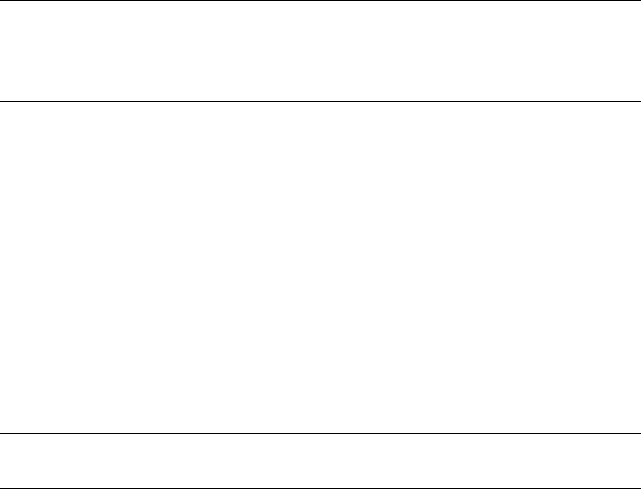
modifier, go to the same sub-object level as you were in when you copied the
set, and click Paste.
NOTE Because sub-object ID numbers vary from object to object, the results of
copying named selection sets between different objects can be unexpected. For
example, if the buffered set contains only entities numbered higher than any that
exist in the target object, no entities will be selected when the set is pasted.
Copy Places a named selection into the copy buffer.
Paste Pastes a named selection from the copy buffer.
Select Open Edges Selects all edges with only one face. In most objects, this
will show you where missing faces exist. Available only at the Edge sub-object
level.
Selection Information
At the bottom of the Mesh Select Parameters rollout is a text display giving
you information about the current selection. If 0 or more than one sub-object
is selected, the text gives the number and type selected. If one sub-object is
selected, the text gives the ID number and type of the selected item.
NOTE When the current sub-object type is Polygon or Element, selection
information is given in faces.
Soft Selection rollout
These controls let you set a gradual falloff of influence between selected and
unselected vertices. See Soft Selection Rollout (Edit/Editable Mesh) on page
1926 .
MeshSmooth Modifier
Modify panel > Make a selection. > Modifier List > Object-Space Modifiers >
MeshSmooth
Make a selection. > Modifiers menu > Subdivision Surfaces > MeshSmooth
The MeshSmooth modifier smoothes geometry in your scene by means of
several different methods. It lets you subdivide the geometry while
interpolating the angles of new faces at corners and edges, and apply a single
smoothing group to all faces in the object. The effect of MeshSmooth is to
round over corners and edges as if they had been filed or planed smooth. Use
1460 | Chapter 9 Modifiers
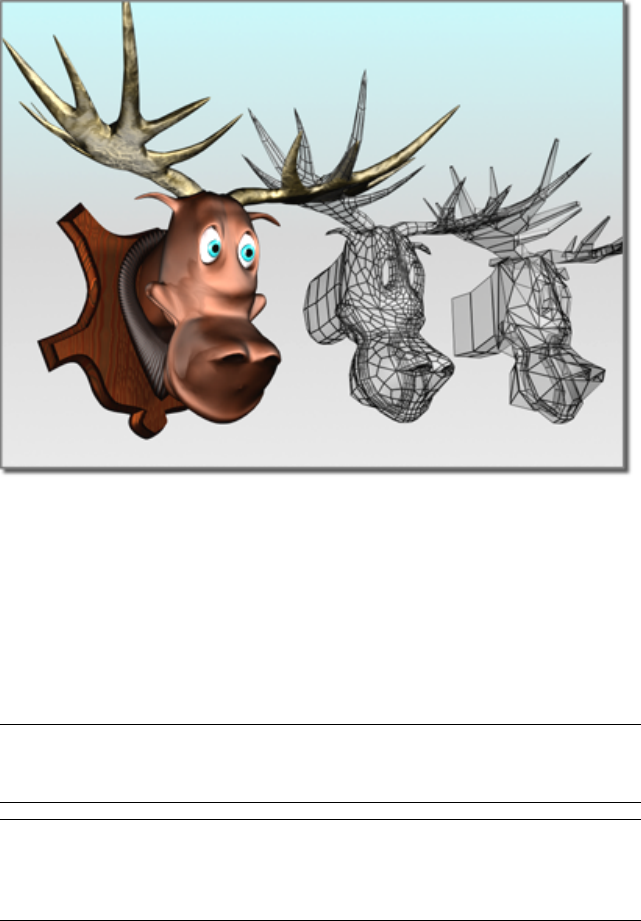
MeshSmooth parameters to control the size and number of new faces, and
how they affect the surface of the object.
Angular model (shown on the right) changed to a smooth model with MeshSmooth
You can use MeshSmooth to produce a Non-Uniform Rational MeshSmooth
object (NURMS for short). A NURMS object is similar to a NURBS object in
that you can set different weights for each control vertex. You can further
control the object's shape by changing edge weights.
MeshSmooth's effect is most dramatic on sharp corners and least visible on
rounded surfaces. Use MeshSmooth on boxes and geometry with crisp angles.
Avoid using it on spheres and similar objects.
TIP To better understand MeshSmooth, create a sphere and a cube and apply
MeshSmooth to both. The cube's sharp corners become rounded, while the sphere's
geometry becomes more complex without changing shape significantly.
NOTE Having an animated deformer placed before a meshsmoothed object that
has had control level editing can result in the meshsmoothed object becoming
distorted. It's recommended that deforming modifiers be placed after the
MeshSmooth modifier in the stack if you're using the deformers for animation.
MeshSmooth Modifier | 1461
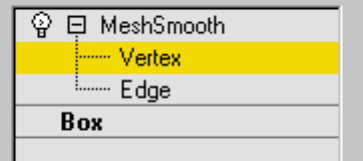
Procedures
To apply MeshSmooth to an object:
1Select an angular object.
2Apply the MeshSmooth modifier.
3Set MeshSmooth parameters.
To apply MeshSmooth to sub-objects:
1Select an object.
2Apply a Mesh Select modifier.
3Select a group of vertices or faces.
4Apply MeshSmooth.
5In the Subdivision Method rollout, turn off Apply To Whole Mesh.
This lets MeshSmooth work only on the sub-object selection.
6Set MeshSmooth parameters.
Interface
Modifier Stack
Vertex At this sub-object level you can transform or edit vertices in the
smoothed mesh.
Edge At this sub-object level you can transform or edit face edges in the
smoothed mesh.
See Local Control rollout on page 1466 .
For more information on the stack display, see Modifier Stack on page 7427 .
1462 | Chapter 9 Modifiers
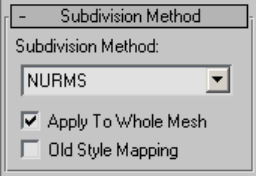
Subdivision Method rollout
Subdivision Method list Choose one of the following to determine the output
of the MeshSmooth operation:
■NURMS Produces Non-Uniform Rational MeshSmooth object (NURMS
for short). The Strength and Relax smoothing parameters are unavailable
with the NURMS type.
A NURMS object is similar to a NURBS object in that you can set different
weights for each control vertex. You can further control the object's shape
by changing edge weights. See Display/Weighting group, following, for
further information on changing weights.
■Classic Produces three- and four-sided facets. (This is the same as applying
MeshSmooth in version 2.x without turning on Quad Output.)
■Quad Output Produces only four-sided facets (assuming you don't look
at the hidden edges, since the object is still made up of triangular faces).
If you apply this with default parameters to a whole object, like a box, it's
topologically exactly the same as Tessellate on page 1743 , edge-style.
However, rather than using tension to project face and edge vertices out
of the mesh, use the MeshSmooth Strength to relax the original vertices
and the new edge vertices into the mesh.
Apply To Whole Mesh When turned on, any sub-object selection passed up
the stack is ignored and MeshSmooth is applied to the entire object. Note that
the sub-object selection is still passed up the stack to any subsequent modifiers.
Old Style Mapping Uses the 3ds Max version 3 algorithm to apply
MeshSmooth to the mapping coordinates. This technique tends to distort the
underlying mapping coordinates as it creates new faces and as texture
coordinates shift.
MeshSmooth Modifier | 1463
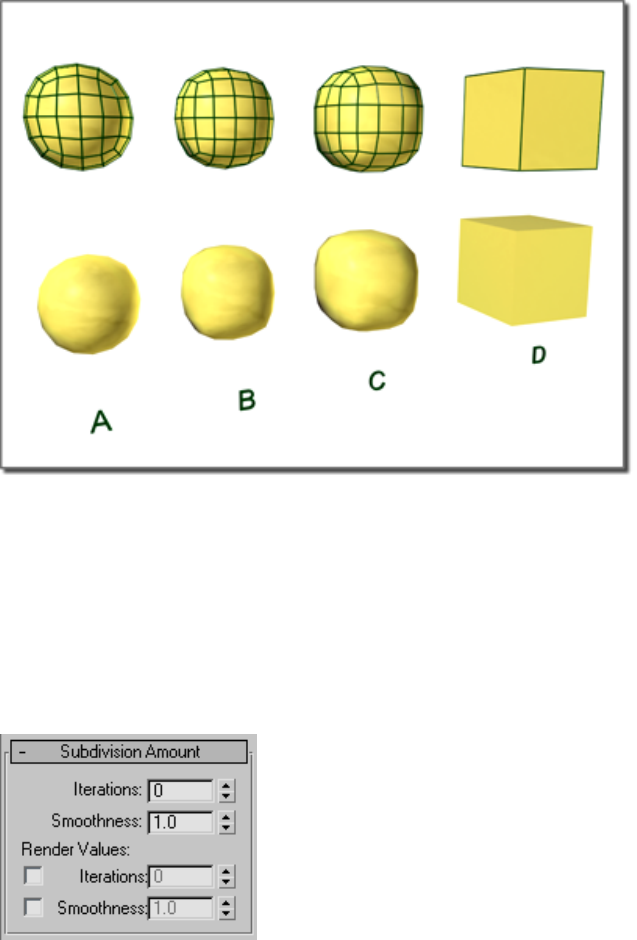
Effect of MeshSmooth with two iterations on a cube and different iteration method:
A. NURMS
B. Quad
C. Classic
D. Original object with no MeshSmooth
Subdivision Amount rollout
Sets how many times to apply MeshSmooth.
Iterations Sets the number of times the mesh is subdivided. When you
increase this value, each new iteration subdivides the mesh by creating
1464 | Chapter 9 Modifiers
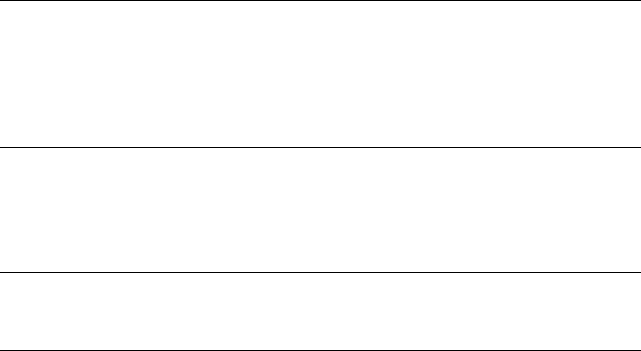
smoothly interpolated vertices for every vertex, edge, and face from the
iteration before. The modifier then subdivides the faces to use these new
vertices. Default=0. Range=0 to 10.
The default value of 0 iterations allows you to modify any setting or parameter,
such as the type of MeshSmooth or the update options, before the program
starts subdividing the mesh.
NOTE Be cautious when increasing the number of iterations. The number of
vertices and faces in an object (and thus the calculation time) can increase as much
as four times for each iteration. Applying four iterations to even a moderately
complex object can take a long time to calculate. You can press Esc to stop
calculation; this also automatically sets Update Options to Manually. Reduce the
Iterations value before setting Update Options back to Always.
Smoothness Determines how sharp a corner must be before faces are added
to smooth it. Smoothness is calculated as the average angle of all edges
connected to a vertex. A value of 0.0 prevents the creation of any faces. A
value of 1.0 adds faces to all vertices even if they lie on a plane.
TIP To subdivide only sharp edges and corners, use a Smoothness value of less
than 1.0. To see the subdivisions in Wireframe/Edged Faces viewports, turn off
Isoline Display on page 1467 .
Render Values These let you apply a different number of smoothing iterations
and a different Smoothness value to the object at render time. Typically you
would use a low number of iterations and a lower Smoothness value for
modeling, and higher values for rendering. This lets you work quickly with a
low-resolution object in the viewports, while producing a smoother object for
rendering.
Iterations Lets you choose a different number of smoothing iterations on
page 1464 to be applied to the object at render time. Turn on Iterations, and
then use the spinner to its right to set the number of iterations.
Smoothness Lets you choose a different Smoothness value to be applied to
the object at render time. Turn on Smoothness, then use the spinner to its
right to set the smoothness value.
MeshSmooth Modifier | 1465
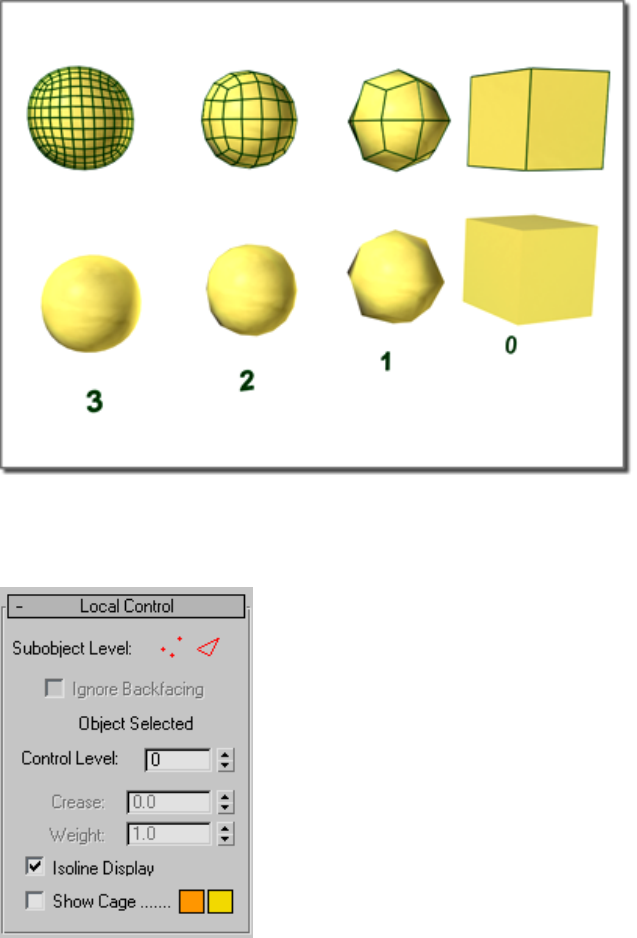
From right to left, effect of increasing the number of iterations
Local Control rollout
Sub-object Level Turns Edge or Vertex level on or off. When both levels are
off, you're working at the object level. Information about the selected edges
1466 | Chapter 9 Modifiers
or vertices is displayed in the message area under the Ignore Backfacing check
box.
Ignore Backfacing When on, selection of sub-objects selects only those
sub-objects whose normals make them visible in the viewport. When off (the
default), selection includes all sub-objects, regardless of the direction of their
normals.
Control Level Allows you to see the control mesh after one or more iterations
and to edit sub-object points and edges at that level. Transform controls and
the Weight setting are available for all sub-objects at all levels. The Crease
setting is available only at the Edge sub-object level.
Crease Creates a discontinuity on a surface so you get a hard edge, such as
a wrinkle or lip. You select one or more edge sub-objects and adjust the Crease
setting; the crease appears in the surfaces associated with the selected edges.
Available only at the Edge sub-object level.
Weight Sets the weight of selected vertices or edges. Increasing a vertex
weight "pulls" the smoothed result toward that vertex. Edge weights are more
complex and behave in an opposite manner in some respects. They aren't
really "weights" as such, but "knot intervals," in NURBS terminology.
Consequently, increasing an edge weight tends to push the smoothed result
away. Kinks will form in the result if weights of 0 are used.
Isoline Display When on, the software displays only isolines: the object's
original edges, before smoothing. The benefit of using this option is a less
cluttered display. When off, the software displays all faces added by
MeshSmooth; thus, higher Iterations settings (see Subdivision Amount Rollout
on page 1464 ) result in a greater number of lines. Default=on.
Show Cage Toggles the display of a two-color wireframe that shows the
modified object before subdivision. The cage colors are shown as swatches to
the right of the check box. The first color represents unselected edges at the
Vertex sub-object level, and the second color represents unselected edges at
the Edge sub-object level. Change a color by clicking its swatch.
Soft Selection rollout
Soft Selection controls affect the action of sub-object Move, Rotate, and Scale
functions. When these are on, 3ds Max applies a spline curve deformation to
unselected vertices surrounding the transformed selected sub-object. This
provides a magnet-like effect with a sphere of influence around the
transformation.
For more information, see Soft Selection Rollout on page 1926 .
MeshSmooth Modifier | 1467
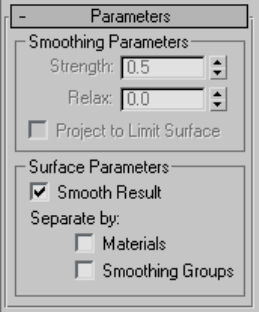
Parameters rollout
Parameters rollout > Smoothing Parameters group
These settings are available only when MeshSmooth Type is set to Classic or
Quad Output. Also, Project To Limit Surface is available only in Classic mode.
Strength Sets the size of the added faces using a range from 0.0 to 1.0.
■Values near 0.0 create small faces that are very thin and close to the original
vertices and edges.
■Values near 0.5 size faces evenly between edges.
■Values near 1.0 create large new faces and make the original faces very
small.
Relax Applies a positive relax effect to smooth all vertices.
Project to Limit Surface Places all points on the "limit surface" of the
MeshSmooth result, which is the surface that would be produced after an
infinite number of iterations. The topology is still controlled by the number
of iterations.
Parameters rollout > Surface Parameters group
Applies smoothing groups to the object and restrict the MeshSmooth effect
by surface properties.
Smooth Result Applies the same smoothing group to all faces.
1468 | Chapter 9 Modifiers
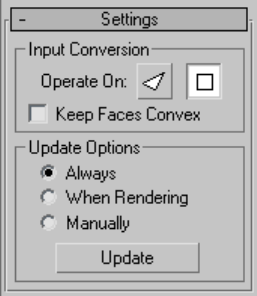
Separate by Materials Prevents the creation of new faces for edges between
faces that do not share Material IDs.
Separate by Smoothing Groups Prevents the creation of new faces at edges
between faces that don't share at least one smoothing group.
Settings rollout
Settings rollout > Input Conversion group
Operate On Faces/Polygons Operate On Faces treats every triangle as a face
and smoothes across all edges, even invisible edges. Operate On Polygons
ignores invisible edges, treating polygons (like the quads making up a box or
the cap on a cylinder) as a single face.
Keep Faces Convex (Available only with Operate On Polygons mode.) Keeps
all input polygons convex. Selecting this option causes non-convex polygons
to be handled as a minimum number of separate faces, each of which is convex.
(Turn on Display/Weighting group > Display Control Mesh to see what's
happening here.)
"Convex" means that you can connect any two points in the polygon with a
line that doesn't go outside the polygon. Most letters aren't convex. In the
capital letter "T," for example, you can't connect the upper-left corner to the
bottom with a straight line without going outside the shape. Circles, rectangles,
and regular polygons are all convex.
Problems that can occur with non-convex faces include the fact that changes
in the geometry of the input object can result in a different topology for the
MeshSmooth result. For instance, in a box, if you drag one of the top corners
across the middle of the top face, the box becomes non-convex. MeshSmooth
MeshSmooth Modifier | 1469
would then see this as two triangles instead of one quad, and the number of
points in the result would change.
If you need to make sure your output topology is stable, turn this off. If you
have a lot of letters or other non-convex faces in your mesh, however, you'll
probably want it on.
Settings rollout > Update Options group
Sets manual or render-time update options, for situations where the complexity
of the smoothed object is too high for automatic updates. Note that you can
also set a greater degree of smoothing to be applied only at render time, on
the Subdivision Amount rollout.
Always Updates the object automatically whenever you change any
MeshSmooth settings.
When Rendering Updates the viewport display of the object only at render
time.
Manually Turns on manual updating. When manual updating is selected,
any settings you change don't take effect until you click the Update button.
Update Updates the object in the viewport to match the current MeshSmooth
settings. Works only when you choose When Rendering or Manually.
Resets rollout
This rollout allows you to go back to default or initial settings on any changes
you made such as sub-object transforms (geometric edits), and changes to
edge creases, vertex weights, and edge weights.
You can reset changes for all control levels or to the current control level.
Turn on the reset option for the sub-object level you want, and then click the
appropriate button.
1470 | Chapter 9 Modifiers
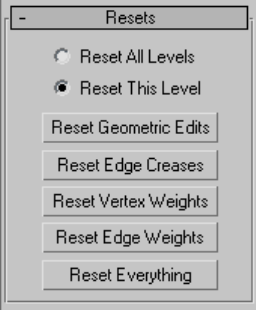
Reset All Levels Returns to the default or initial settings for geometric edits,
creases, and weights for all sub-object levels.
Reset This Level Returns to the default or initial settings for geometric edits,
creases, and weights for the current sub-object level.
Reset Geometric Edits Returns to the default or initial settings for any
transforms made to vertices or edges.
Reset Edge Creases Returns to the default or initial setting for edge creases.
Reset Vertex Weights Returns to the default or initial setting for vertex
weights.
Reset Edge Weights Returns to the default or initial setting for edge weights.
Reset Everything Returns to the default or initial setting for everything.
Mirror Modifier
Modify panel > Make a selection. > Modifier List > Object-Space Modifiers >
Mirror
Make a selection. > Modifiers menu > Parametric Deformers > Mirror
The Mirror modifier provides a parametric method of mirroring an object or
a sub-object selection. You can apply the Mirror modifier to any type of
geometry, and you can animate the mirror effect by animating the modifier's
gizmo.
Mirror Modifier | 1471
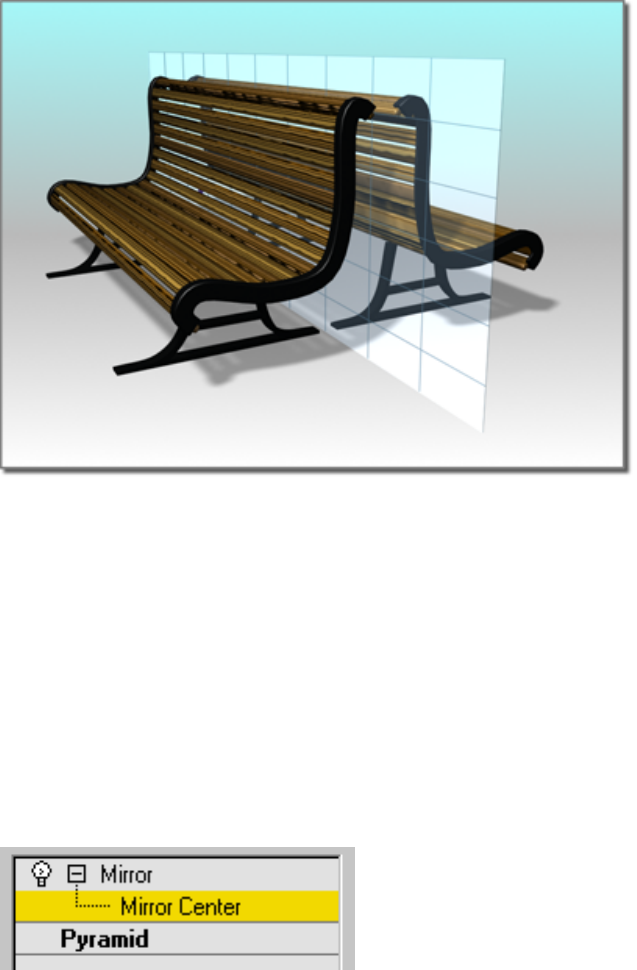
Mirroring a bench
Procedures
To apply the Mirror modifier:
1Apply the Mirror modifier to a selection.
2Set the axis or axis pair on which to mirror the object.
3To create a mirrored pair, specify an Offset amount and turn on Copy.
Interface
Modifier Stack
1472 | Chapter 9 Modifiers
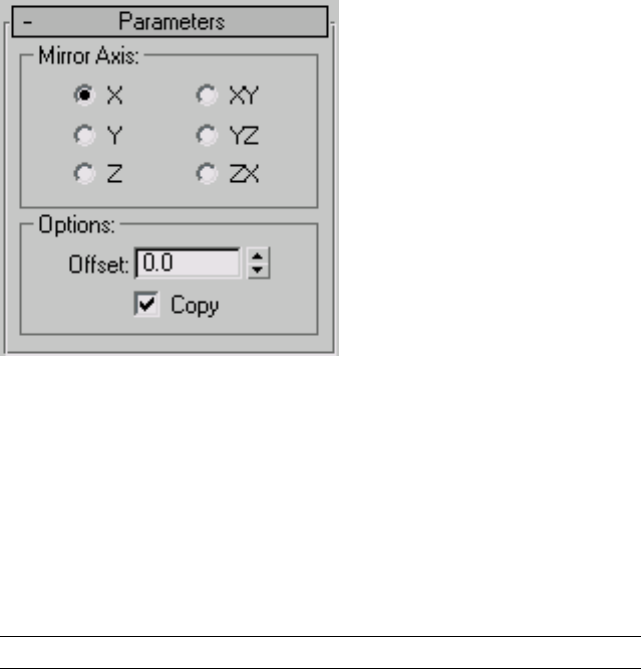
Mirror Center Represents the axis of the mirror effect. You can move, rotate
or scale the gizmo to affect the mirroring. You can animate the gizmo
transforms, which you can't do with the toolbar Mirror on page 911 tool.
For more information on the stack display, see Modifier Stack on page 7427 .
Parameters rollout
Mirror Axis group
X, Y, Z, XY, YZ, ZX Specify the axis or axes about which the mirroring takes
place. You can usually see the effect in the viewport as you select the option.
Options group
Offset Specifies the offset, in units, from the mirror axis. This is an animatable
parameter.
Copy Copies the geometry rather than simply mirroring it.
NOTE The Copy option affects only geometry with triangular meshes.
Morpher Modifier
Select a mesh, patch, or NURBS object. > Modify panel > Modifier List >
Morpher
Morpher Modifier | 1473
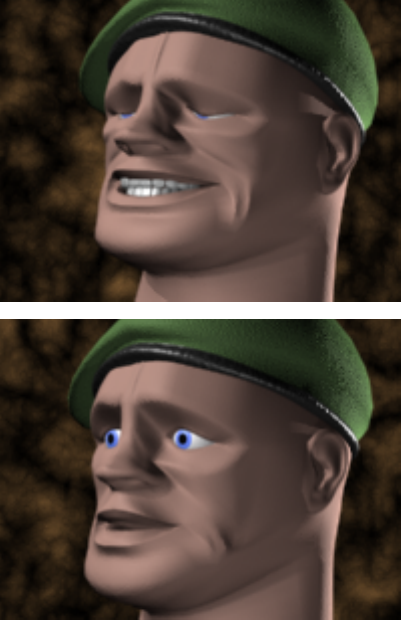
Select a mesh, patch, or NURBS object. > Modifiers menu > Animation
Modifiers > Morpher
On this patch model, morph targets are created by moving control vertices and tangent
handles in an Editable Patch.
Use the Morpher modifier to change the shape of a mesh, patch, or NURBS
model. You can also morph shapes (splines), and World Space FFDs. As well
as morphing from one shape to another, the Morpher modifier also supports
material morphing.
Morphing is commonly used for lip sync and facial expression on a 3D
character, but can be used to change the shape of any 3D model. There are
100 channels available for morph targets and materials. Channel percentages
can be mixed, and the result of the mix can be used to create a new target.
On a mesh object, vertex count on the base object and targets must be the
same. On a patch or NURBS object, the Morpher modifier works on control
1474 | Chapter 9 Modifiers
points only. This means that the resolution of patches or NURBS surfaces can
be increased on the base object to increase detail at render time.
A Flex modifier above the Morpher modifier is aware of vertex/control point
motion in the Morpher modifier. If, for example, a jaw is morphed to slam
shut, then the Flex modifier placed above the Morpher modifier in the modifier
stack can be used to make the lips quiver to simulate soft tissue.
See also:
■Morpher Material on page 5554
Lip Sync and Facial Animation
For lip sync and facial animation, create a character's head in an "at rest" pose.
The head can be a mesh, patch, or NURBS model. Copy and modify the original
head to create the lip-sync and facial-expression targets. Select the original or
"at rest" head and apply the Morpher modifier. Assign each lip-sync and
facial-expression target to a channel in the Morpher modifier. Load an audio
file in the Track View sound track, turn on the Auto Key button, scrub the
time slider, and view the audio waveform in Track View to locate frames for
lip sync. Then set the channel spinners on the Morpher modifier to create
key frames for lip position and facial expression.
Teeth can either be a part of the model or animated separately. If the teeth
and head are two different objects, model the teeth in an open position, and
then apply the Morpher modifier, and create one target with the teeth closed.
Eyes and head motion can be animated after the morph keys are created.
Morph Targets for Speech
Nine mouth shape targets are commonly used for speech. If your character
speaks an alien dialect, don't hesitate to create extra morph targets to cover
these mouth shapes.
Include cheek, nostril, and chin-jaw movement when creating mouth position
targets. Examine your own face in a mirror or put a finger on your face while
mouthing the phonemes, if necessary, to establish the direction and extent
of cheek motion.
Set lip-sync keys by viewing the audio waveform as well as listening to the
sound as you scrub the time slider. Many mouth-position keys benefit from
being set a frame early. Often the mouth must assume a shape before the
appropriate sound is uttered. For the word "kilo", the "K" mouth shape precedes
the actual sound, for example.
Morpher Modifier | 1475
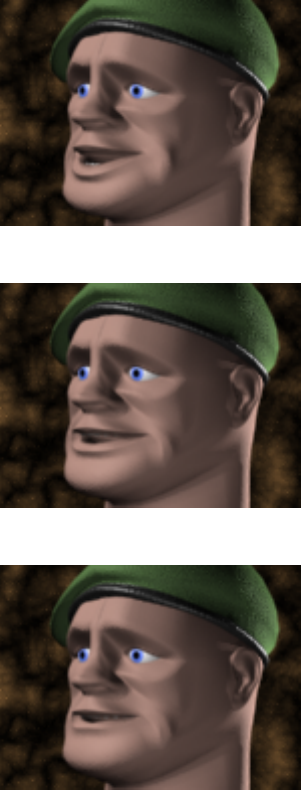
A, I
E
F,V
1476 | Chapter 9 Modifiers
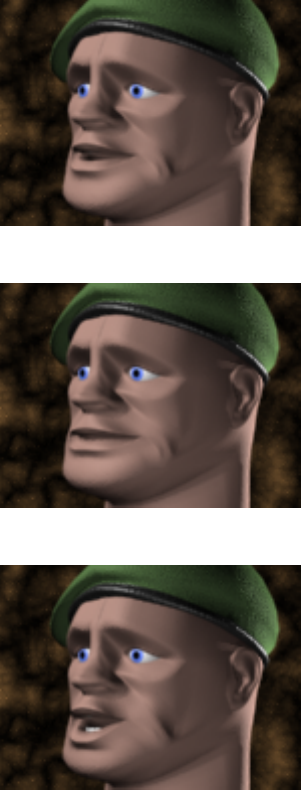
C, D, G, J, K, N, S, T, Y, Z
L,T
O
Morpher Modifier | 1477
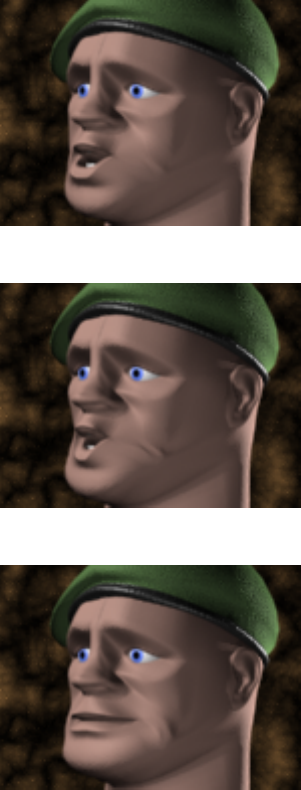
U
W,Q
M,B,P (This target can be the same shape as the "at rest" base object)
Morph Targets for Expression
Create as many expression targets as necessary for the character. Joy, sadness,
surprise, evil can all have their own targets. Depending on the personality of
the character, certain targets, like a terror target, may not be necessary. Targets
like nostril flare, jaw-muscle bunching, temple twitching can be effective to
1478 | Chapter 9 Modifiers
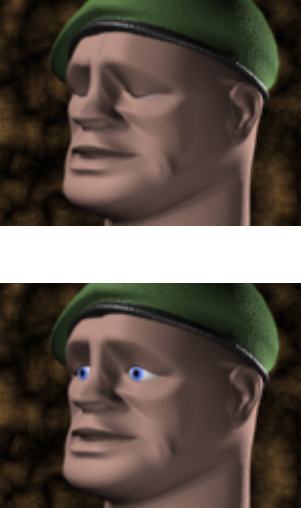
give a character an edge. Each morph channel can contain a material as well:
as you morph the brows up, a bump map can crease the forehead, for example.
Save time and create targets as the need arises; if the audio file or scene you
are working on requires a look of surprise, create the "surprise" target while
the mood of the scene is with you.
If the character has teeth, copy the teeth and the base head to create a new
target. The teeth act as a guide to shape and position the lips.
Blink
Brows up
Morpher Modifier | 1479

A blend of the Pain, Blink, and Brows targets
Procedures
Example: To add the morpher modifier to an object and assign a morph target
to a channel:
1 On the Create panel, click Geometry.
2On the drop-down list, choose Patch Grids.
3On the Object Type rollout, click Quad Patch.
4In the Top viewport, click and drag to create a patch grid.
5 On the Modify panel, on the modifier stack display, right-click
Quad Patch and choose Convert To: Editable Patch from the right-click
menu.
The base object is now an Editable Patch.
6 In the Top viewport, use Shift+Move to create a copy of the patch
object.
7 On the Modify panel, on the Selection rollout, click Vertex.
8 In the Front viewport, move patch vertices to deform the patch
surface.
1480 | Chapter 9 Modifiers

9 In the stack display, choose Editable Patch to go to the object (top)
level. (The highlight should change from yellow to gray, and the Vertex
sub-object icon is no longer displayed at the right of the stack.)
10 Select the first patch object.
11 On the Modify panel, choose Morpher from the Modifier List.
The Morpher modifier is added to the modifier stack.
12 On the Morpher modifier, on the Channel List rollout, right-click the
first channel (over the word "empty").
A right-click menu displays.
13 Choose Pick from Scene on the right-click menu, and click the deformed
patch grid in the viewports.
QuadPatch02 is listed in the channel as a morph target.
14 Drag the Channel spinner, to the right of QuadPatch02, up and down.
The flat patch grid "morphs" to the shape of the target.
To use progressive morphing:
1Create starting and ending morph targets, and one or more intermediate
targets.
2Apply the Morpher modifier to the starting morph target, and click Load
Multiple Targets to load the starting and ending morph targets.
3In the Channel List rollout, select the channel you want to be influenced
by an intermediate target.
4In the Channel Parameters rollout, click Pick Object from Scene, and
select the intermediate target.
5In the Progressive Morph group Target List, set the Target % to determine
the degree to which each target affects the channel.
6Use the down arrow button to move the original channel target to the
bottom of the Target List.
Morpher Modifier | 1481
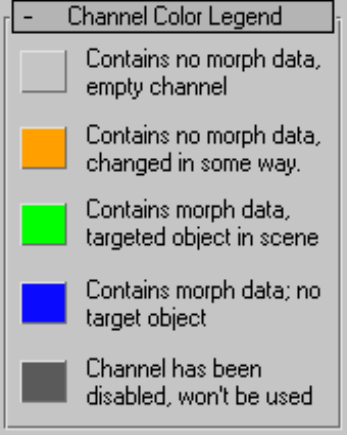
Interface
Whatever is assigned as the default float controller in the software will be
assigned as the float controller on the morph channels as well. Float controllers
handle the interpolation between keys; Bezier is the default float controller.
You can assign the TCB float controller to the morph channels in Track View,
if you prefer.
For morphing, the Bezier controller allows you to use function curves with
vector handles on the keys for smoothing and easing control of interpolation
in Track View. Default parameters of the TCB controller, however, handles
morph interpolation with less overshoot. Try using both controllers, to decide
which one you prefer.
Gray The channel is empty, and has not been edited.
Orange The channel has been changed in some way but contains no morph
data.
An artist may wish to name a channel and set up its parameters before actually
assigning a morph target.
Green The channel is live. The channel contains morph data and the target
object still exists in scene (the target is available for refresh).
Blue The channel contains morph data but the target has been deleted from
the scene.
1482 | Chapter 9 Modifiers
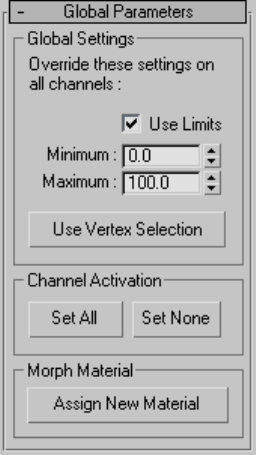
Dark Gray The channel is disabled.
■There is a problem with the morph, the topology of the base object, or
targets, have changed and are no longer valid; for example, the vertex
count might have changed. The channel cannot be used.
■The channel is not active. This is controlled by the Channel is Active toggle
in the Channel Parameters rollout.
■Disabled channels are not included in the morph result.
Global Parameters rollout
Global Settings group
Use Limits Use the minimum and maximum limits for all channels.
You can turn off limits to double purpose a target. The target for a smile can
be used to turn the corners of the mouth down using negative values for
example.
Minimum Sets the minimum limit.
Maximum Sets the maximum limit.
Morpher Modifier | 1483
Use Vertex Selection Turn on to limit morphing to vertices selected in a
modifier below the Morpher modifier in the modifier stack.
If your are using Character Studio Physique, limit morph animation on the
base object to just the head and exclude the neck, for example. Place the
Physique modifier above the Morpher modifier and assign the head vertices
as rigid (green) in the Physique modifier.
Channel Activation group
Set All Click to activate all channels.
Set None Click to deactivate all channels.
Morph Material group
Assign New Material Click to assign the Morpher material to the base object
(the object to which the Morpher modifier is applied).
Open the Material Editor to view and edit the Morpher material. There is a
direct correlation between the Channel Material Maps and the Channel list
in the Morpher modifier (100 channels and 100 maps). For example, if channel
1 contains a brows up target and the Morpher material has a material assigned
to map 1, then, as the brows are morphed so is the material.
In the Morpher material, if a material is assigned to a map or channel that
has no morph target in the Morpher modifier, then the channel spinner in
the Morpher modifier can be used to simply morph the material on a static
object. See Morpher Material on page 5554 .
1484 | Chapter 9 Modifiers
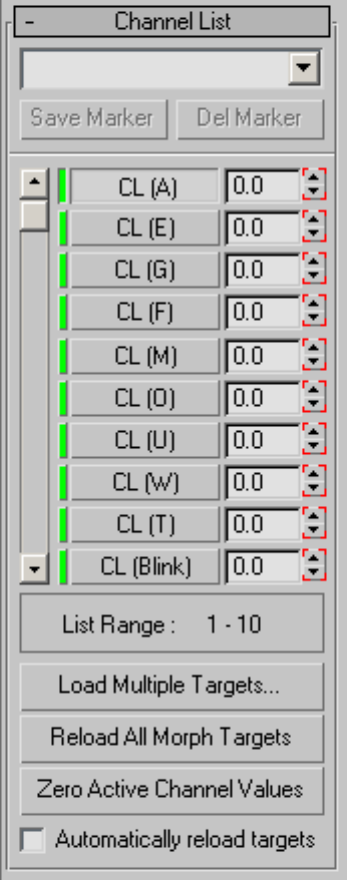
Channel List rollout
The upper section of the Channel List rollout contains controls for managing
markers, which designate different locations in the list of morph targets. For
Morpher Modifier | 1485
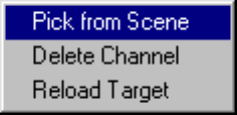
example, channels 15 through 24 might contain all the emotion targets. Rather
than scrolling to display these tracks, you can choose a marker from the list
to display those channels.
[marker drop-down list] Choose a previously saved marker in the list, or
enter a new name in the text field and click Save Marker to create a new
marker.
For example, channel 15 through 24 might contain all the emotion targets.
Rather than scrolling to display these tracks, you can choose a marker from
the list to display these channels in the list.
Save Marker Move the scroll bar to frame a particular set of 10 channels,
enter a name in the text field, and then click Save Marker to store the channel
selection.
Delete Marker Choose a marker name to delete from the drop-down list,
and then click Delete Marker to delete it.
Channel List The Morpher modifier provides up to 100 morph channels.
Scroll through the channels using the slider. Once you've assigned a morph
target to a channel, the target's name appears in the channel list. Each channel
has a percentage value field and a spinner to change the value.
You can change channel names and order in the Channel Parameters on page
1487 rollout.
Right-click a morph channel to display a right-click menu:
Pick from Scene Choose this command and select an object in the viewports
to assign a morph target to the channel.
Delete Channel Deletes the morph data, name and parameters from the
channel. Displays only if the channel has data.
Reload Target Retrieves morph data from the target. Use this after editing
a target.
1486 | Chapter 9 Modifiers
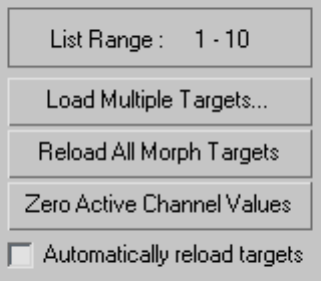
List Range Displays the range of visible channels in the channel list.
Load Multiple Targets Load multiple morph targets into empty channels by
selecting object names in the selection dialog and clicking Load.
If there are more targets than empty channels, a warning displays and the
channels are not assigned.
Reload All Morph Targets Reloads all the morph targets.
If the targets have been edited, the channels are updated to reflect the changes.
If a morph target has been deleted from the scene, then the morpher updates
using the stored data in the channel, functions using the last stored morph
data.
Zero Active Channel Values Click to create keys with a value of 0 for all
active morph channels, if the Auto Key is on.
This is handy to prevent key interpolation from distorting the model. First
click Zero Active Channel Values, and then set a particular channel to the
value you want; only the altered channel affect the model.
Automatically reload targets Turn this on to allow animated targets to be
updated dynamically by the Morpher modifier. There is a performance penalty
when using this option.
Channel Parameters rollout
The channel number button and channel name field at the top of this rollout
reflect the current active channel in the channel list.
Morpher Modifier | 1487

[channel number] Click the number next to the channel name to display a
menu. Use commands on the menu to group and organize channels, or to
locate a channel.
1488 | Chapter 9 Modifiers
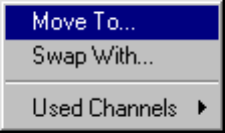
Move To Displays the Channel Operations dialog. To move the current
channel to the selected channel, choose a channel from the list, and click
Move To.
Swap With Displays the Channel Operations dialog. To swap the current
channel with the selected channel, choose a channel from the list, and click
Swap With.
Used Channels Displays a list of active channels. Choose a channel to place
it at the top of the channel list display in the Channel List rollout.
Channel Name Displays the name of the current target. Change the name
of the target in the text field if necessary. Parameter changes in the Channel
Parameters rollout affect the current target.
Channel is Active Toggles a channel on and off. Inactive channels do not
affect the morph result. Use this control to turn off certain channels to focus
on animating other channels.
Create Morph Target group
Pick Object from Scene Turn on and click an object in the viewports to
assign a morph target to the current channel. Picking an object adds it to the
Progressive Morph list.
Capture Current State Choose an empty channel to activate this function.
Click to create a target using the current channel values.
The captured channel is always blue because there is morph data but no specific
geometry. Use Extract to create a mesh copy of the captured state.
Delete Deletes the target assignment for the current channel.
Extract Choose a blue channel and click this option to create an object from
the morph data.
If you have used Capture Current State to take a snapshot of a group of channel
values, but then want to edit it, use Extract to make a new object, pick it as
the channel's target, and then start editing.
Morpher Modifier | 1489
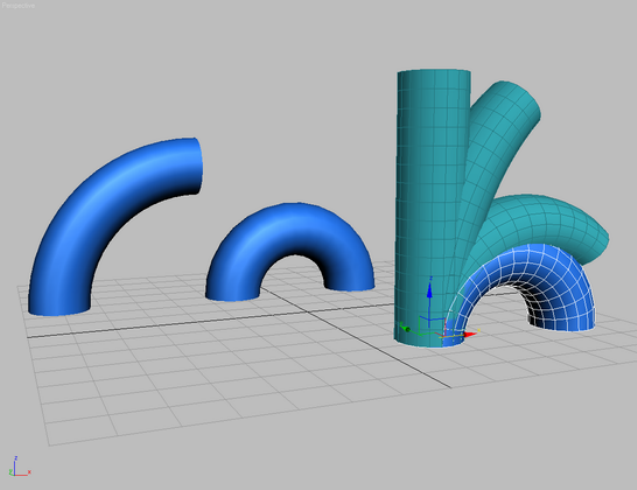
Channel Settings group
Use Limits Turn on to use limits on the current channel if Use Limits is
turned off in the Global Parameters rollout.
Minimum Sets the lower limit.
Maximum Sets the upper limit.
Use Vertex Selection Morphs only selected vertices on the current channel.
Progressive Morph group
Progressive morphing performs a tension-based interpolation, similar to the
TCB animation controller, that creates smooth interpolation through each
intermediary targets. This provides the artist with an unprecedented amount
of control over the morph transformation.
Morphed object using multiple, intermediary targets
1490 | Chapter 9 Modifiers
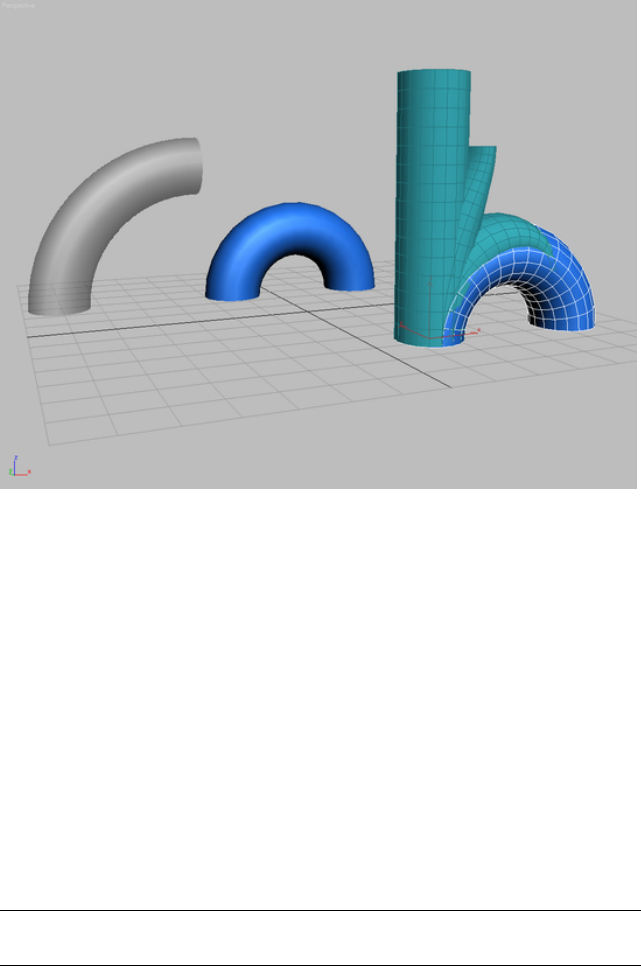
Morphed object using a single target
When morphing from one target to another, the object can sometimes pass
through intermediary stages that are not desirable. For example, morphing a
straight cylinder directly to a bent cylinder causes the cylinder to squash at
intermediate stages.
You could get a better result by creating several intermediate morph targets
for the object, and using them as channels. However, an easier solution is to
create fewer intermediate targets, and use progressive morphing. With
progressive morphing, you do not use the intermediate targets as channels;
you use them to influence the end targets.
Target List Lists all intermediary morph targets associated with the current
channel. To add morph targets to the list, click Pick Object from Scene.
Move Up Moves the selected intermediary morph target up in the list.
Move Down Moves the selected intermediary morph target down in the list.
TIP For best results, move the original morph target (the one in the channel) to
the bottom of the list.
Morpher Modifier | 1491
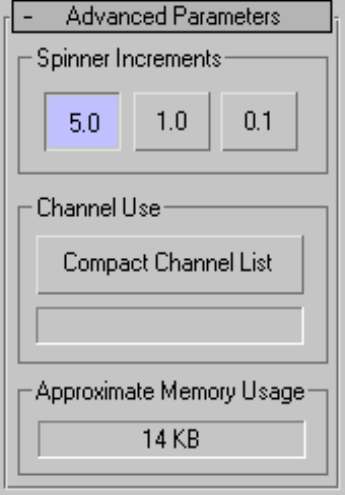
Target % Specifies how much the selected intermediate morph target
contributes to the overall morph solution.
Tension Specifies the overall linearity of the vertex transformation between
intermediary morph targets. A value of 1.0 creates a “loose” transition, causing
the interpolation to overshoot each target slightly. A value of 0.0 creates a
direct, linear transformation between each intermediary target.
Delete Target Deletes the selected intermediary morph target from the target
list.
Reload Morph Target Reloads data from the current target into the channel.
Reload a target if it has been adjusted or edited.
If the active morph target entry in the channel list is empty, this button is
unavailable, and displays the text “No Target to Reload.”
Advanced Parameters rollout
Spinner Increments Specify fine or coarse spinner increments. 5.0 is coarse
and 0.1 is fine. Default=1.0
1492 | Chapter 9 Modifiers

Compact Channel List Compact the channel list by filling in any empty
channels in between assigned channels. The status window displays how many
channels were moved.
Approximate Memory Usage Displays an approximation of the current
memory usage.
MultiRes Modifier
Select an object. > Modify panel > Modifiers List > Object–Space Modifiers >
MultiRes
Make a selection. > Modifiers menu > Mesh Editing > MultiRes
The MultiRes modifier reduces the memory overhead needed to render models
by decreasing the number of vertices and polygons. This is useful not only
within 3ds Max but for game and Web content creators who export models
for use outside of the program. MultiRes offers several advantages over the
Optimize modifier, including faster operation and the ability to specify
reduction as an exact percentage or vertex count.
NOTE
The MultiRes modifier supports the preservation of map channels when face
count is increased or reduced.
MultiRes Modifier | 1493
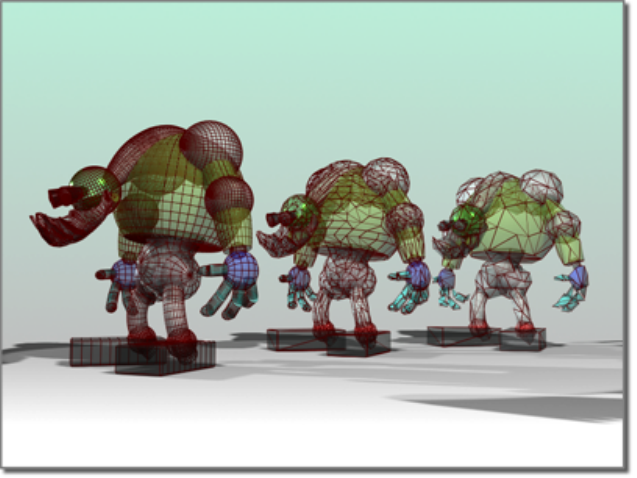
Left: Original model
Center and right: Model progressively simplified by the MultiRes modifier
Modeling Tips for MultiRes
The MultiRes multi-resolution mesh algorithms are designed to be
general-purpose, and yield high-quality meshes on a wide variety of model
types. However, careful modeling can improve the results of the algorithm.
The following are suggestions to yield high-quality multi-resolution meshes:
■Avoid using complex model hierarchies with MultiRes. For such models
you should generate an individual multi-resolution mesh for each model
component, or collapse the entire model into a single mesh. In general,
single-skin meshes work best with animation engines like Physique in
character studio. MultiRes works especially well with single-skin meshes.
■Avoid duplicating vertices. The presence of extra vertices is an
often-overlooked artifact of some modeling techniques. The Weld function
in the Edit Mesh modifier on page 1283 and Editable Poly on page 2038 is
useful for cleaning these up.
■Be conservative with texture and normal discontinuities. For example, an
artist might associate multiple texture coordinates with a single vertex.
1494 | Chapter 9 Modifiers

MultiRes will seek to preserve this discontinuity and the border between
the two texture mappings, but it might do so at the expense of model
shape.
■Create high-resolution models. High-resolution models provide MultiRes
with more faces and vertices that describe the shape of the model. The
more initial information MultiRes has about the shape of the model, the
better the decisions it makes in generating a final multi-resolution mesh.
Procedures
To use the MultiRes modifier:
1Select a model and apply the MultiRes modifier.
2In the Generation Parameters group in the MultiRes Parameters rollout,
click the Generate button to initialize the modifier.
3In the Resolution group, use the keyboard or spinner controls to decrease
the Vert Percent or Vert Count value.
As the vertex and polygon counts decrease, the mesh updates in real time
in the viewports.
To maintain part of a mesh at full resolution while reducing the rest:
1Select a model and apply the MultiRes modifier.
2In the modifier stack display, click the + icon next to the MultiRes
modifier to open the sub-object hierarchy.
3Click the Vertex label to access the Vertex sub-object level.
4Select the vertices in areas whose resolution you want to maintain.
5In the Generation Parameters group, turn on Maintain Base Vertices.
6Click the Generate button to initialize or re-initialize the mesh.
Notice that the selected vertices look like asterisks instead of standard
ticks.
7Reduce the resolution as in the first procedure.
The selected vertices are the last to be removed during vertex reduction.
NOTE You can change the base vertices at any time by selecting a different
group of vertices and regenerating the mesh.
MultiRes Modifier | 1495
To merge vertices:
If there are gaps between vertices that you want to close as vertex resolution
decreases, use the Vertex Merging feature of the MultiRes modifier. With vertex
merging, vertices within a given threshold distance eventually collapse during
vertex reduction.
You can estimate the gap length by activating the Select Object tool on page
132 , moving the mouse cursor over the extents of the gap in the active viewport
(it might help to access the Vertex sub-object level), and comparing the values
displayed in the X/Y/Z readouts in the status bar, or use the Tape helper on
page 2546 object to get an exact measurement. Enter the estimated gap length
value in the Threshold field.
1Select a model and apply the MultiRes modifier.
2Turn on Vertex Merging. This makes the Merge Threshold and Within
Mesh controls available.
3Set the appropriate parameters:
■To define the maximum distance over which vertices are merged,
enter a value in Merge Threshold.
■To merge boundaries of adjacent elements and vertices within
elements, turn on Within Mesh.
4Click the Generate button.
The effect of the change is displayed in the object.
After the Generate button is clicked, a busy cursor will display. If the
merge threshold is too large relative to the dimensions of the model, the
busy cursor may display for a long time. To cancel the generation process
at any time, press the Esc key.
1496 | Chapter 9 Modifiers
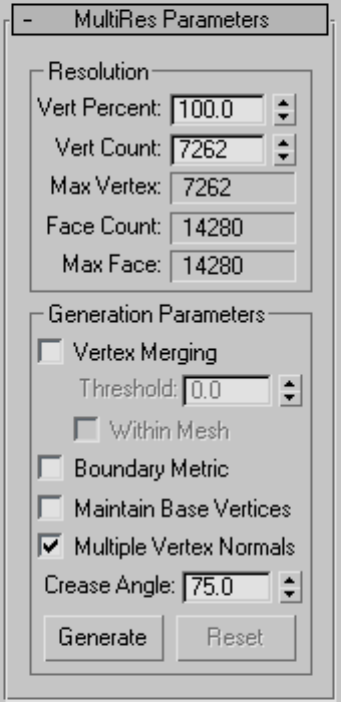
Interface
Resolution group
Use these controls to change the vertex count and overall topology of the
modified object.
Vert Percent The modified object's vertex count as a percentage of the overall
number of vertices in the original mesh. Adjusting this setting alters the Vert
Count value as well.
MultiRes Modifier | 1497
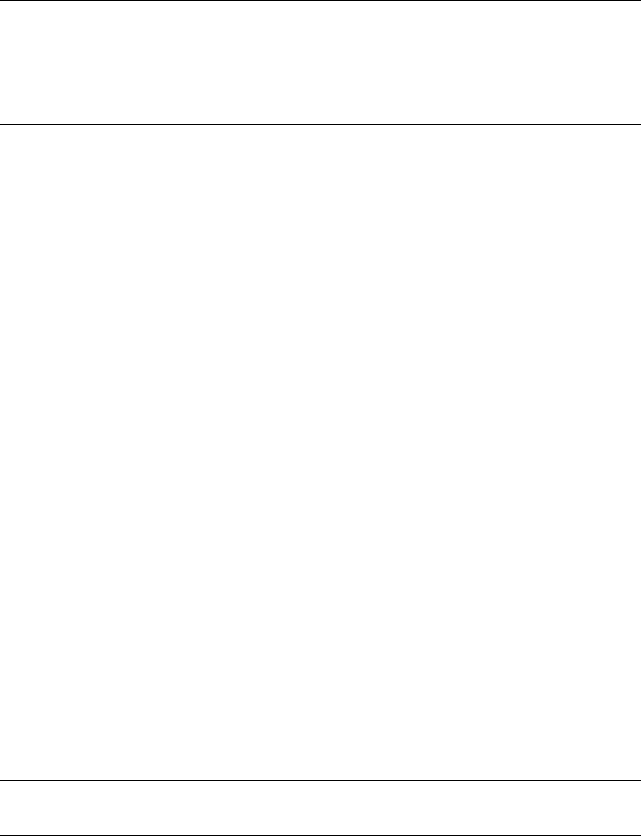
NOTE After you enter a specific percentage, such as 30, you might find that the
software changes the value to a slightly lower one, such as 29.971. This is due to
the relationship between the overall number of vertices in the model and the
percentage calculation. It is not a bug, but simply the closest solution to your
request.
Vert Count The total number of vertices in the modified object. Use this
control to set the maximum number of vertices in the output mesh. Adjusting
this setting alters the Vert Percent value as well.
Max Vertex Displays the vertex count from the original mesh that you
applied MultiRes to. You cannot enter values larger than this in the Vert Count
field.
Face Count Displays the current face count. As you adjust the Vert Percent/Vert
Count settings, the value for the face count will update on the fly.
Max Face Displays the maximum face count.
Generation Parameters group
Vertex Merging When on, lets MultiRes merge vertices between discrete
elements on page 7766 in a model.
For example, if you apply MultiRes to a teapot, which comprises four separate
elements, and turn on Vertex Merging, as you adjust the vertex resolution,
the separate components will meld together into one contiguous
lower-resolution object.
To control Vertex Merging, you can set a Merge Threshold. This value
determines the unit distance within which vertices will merge at a higher rate.
Threshold Sets the maximum distance in 3ds Max units between vertices in
order for those vertices to be considered for merging. Within this distance,
the vertices between elements are welded together at a higher rate as the mesh
is reduced in complexity. Available only when Vertex Merging is on.
NOTE To eliminate only coincident vertices, set Threshold to 0.0. This is similar
to the Weld Vertex function.
Within Mesh When on, MultiRes merges the boundaries of adjacent elements
and vertices within elements. Many objects can contain multiple groups of
vertices that don't share connectivity. A simple example of this is the Teapot
object on page 377 . It comprises four different elements: the body, the handle,
the spout, and the lid. Normally, MultiRes optimizes each discrete element
in a mesh on its own.
1498 | Chapter 9 Modifiers

The default behavior of the Vertex Merging option is to merge vertices between
elements. Turning on Within Mesh causes vertices within elements to be
merged as well.
Boundary Metric When on, MultiRes preserves materials assigned to the
selected model. The material boundaries defined by Material IDs are retained
as long as possible, and are the last to be eliminated at low vertex counts.
Default=off.
Maintain Base Vertices When on, overrides the MultiRes optimization
algorithms and preserves any vertices selected at the MultiRes Vertex sub-object
level as "critical" ones. Use this feature to retain critical features of an object
or character such as its fingers or claws, or other geometry that might become
unrecognizable if reduced too severely.
To select vertices for use with this option, use the MultiRes Vertex sub-object
level. To access this level, first go to the modifier stack display and click the
plus-sign icon next to the MultiRes modifier. This opens its hierarchy, which
consists of the single Vertex sub-object level. Next, click the Vertex entry. The
MultiRes vertices appear on the mesh as blue dots. You can select these using
any standard interactive method, but you cannot transform them.
IMPORTANT After selecting MultiRes sub-object vertices with Maintain Base
Vertices turned on, regenerate the mesh before changing the vertex resolution.
In the following illustration, the clown started out as a high-resolution mesh.
All of the MultiRes vertices in the right half were selected, Maintain Base
Vertices was turned on, and then the vertices were reduced.
MultiRes Modifier | 1499
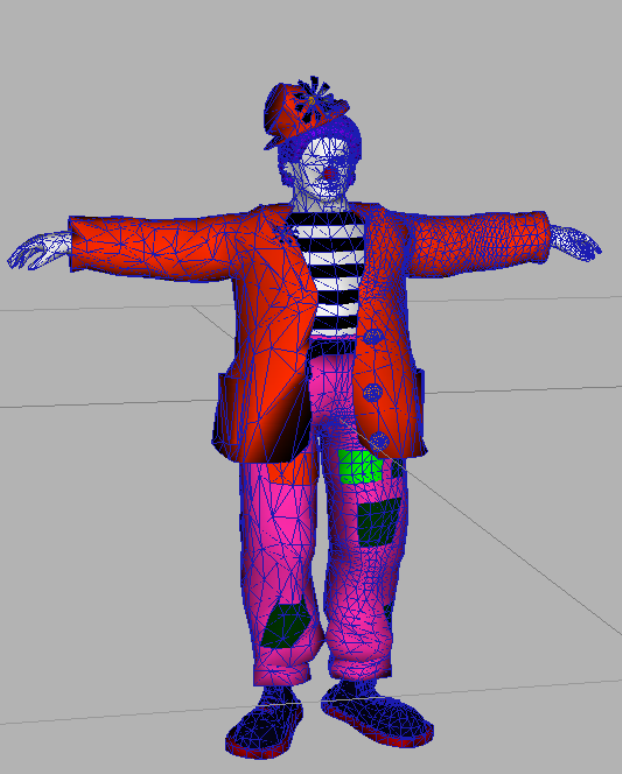
Clown model with left half reduced, right half at original resolution
Multiple Vertex Normals When on, lets MultiRes assign multiple normals
for each vertex. By default, MultiRes generates a single normal per vertex.
If multiple normals are generated, they are applied as the vertex resolution is
decreased and increased.
When the Multiple Vertex Normals option is on, the MultiRes modifier
generates normal updates when the geometry surrounding a vertex changes.
1500 | Chapter 9 Modifiers
You must specify a crease angle in degrees (0.0 - 180.0). The crease angle is the
angle between the face normals. It is used to decide when a normal should
be shared across an edge between two faces.
For example, in a plane defined as a mesh grid of 10 x 10 faces, any two
adjacent faces have a crease angle of zero. In a cube, adjacent faces have a
crease angle of 90 degrees. In general, crease angles approaching 0 yield
smoother shading. Crease angles approaching 180 yield more visible corners.
Crease Angle The value of the crease necessary in order to generate multiple
normals. Available only when Multiple Normals Per Vertex is on.
The optimal crease angle depends on the model; set it interactively and check
the viewport and rendered images for shading effects. While use of Multiple
Vertex Normals enables more accurate shading, it can require more internal
data.
Generate Applies the current MultiRes settings to the modified object. When
you first apply MultiRes to an object, you must use Generate to initialize the
mesh-optimizing algorithm before you can change the vertex count.
Reset Sets all Generation Parameters rollout settings to their values as of the
last time you used Generate. Available only when one or more of these settings
has changed.
Use Reset to review the generation parameters as of the last time you generated
the mesh.
Noise Modifier
Modify panel > Make a selection. > Modifier List > Object-Space Modifiers >
Noise
Make a selection. > Modifiers menu > Parametric Deformers > Noise
The Noise modifier modulates the position of an object's vertices along any
combination of three axes. This important animation tool simulates random
variations in an object's shape.
Using a fractal setting, you can achieve random, rippling patterns, like a flag
in the wind. With fractal settings, you can also create mountainous terrain
from flat geometry.
You can apply the Noise modifier to any kind of object. The Noise gizmo
changes shape to help you visualize the effects of changing parameter settings.
The results of the Noise modifier are most noticeable on objects that have
greater numbers of faces.
Noise Modifier | 1501
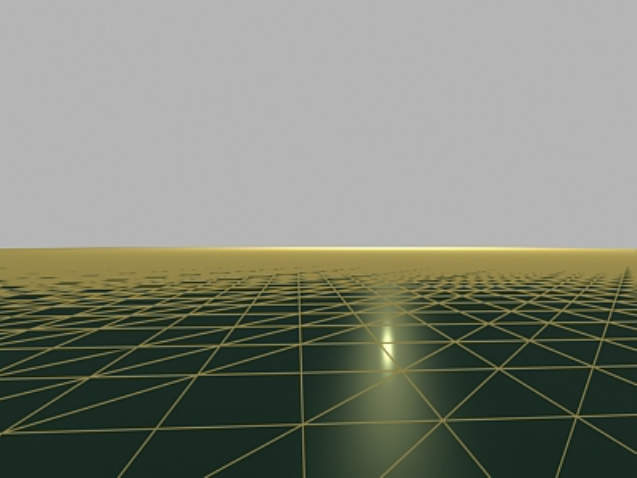
Most of the Noise parameters have an animation controller. The only keys set
by default are for Phase.
Plane with no noise applied
1502 | Chapter 9 Modifiers
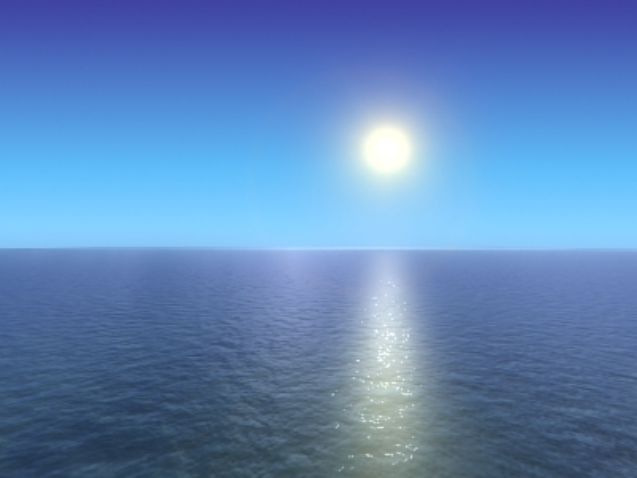
Adding texture to the plane creates a calm sea.
Noise Modifier | 1503
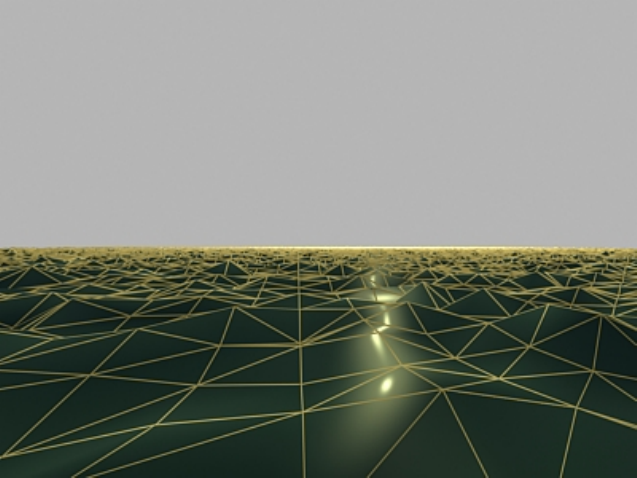
Plane with fractal noise applied
1504 | Chapter 9 Modifiers
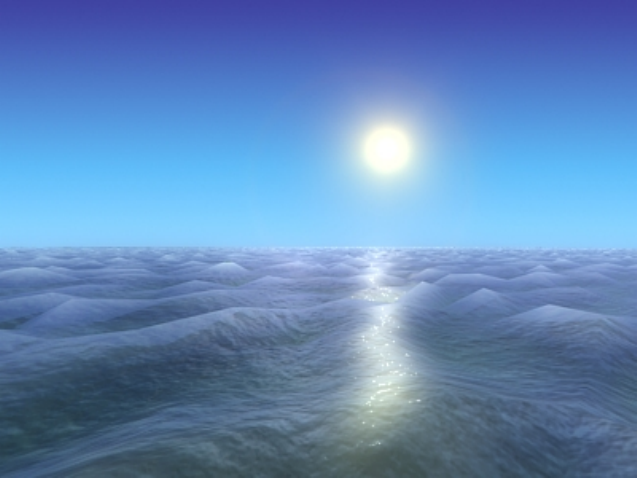
Textured plane with noise creates a stormy sea.
Procedures
To apply noise to an object:
1Select an object and apply the Noise modifier. To animate, move to a
nonzero frame and turn on the Auto Key button.
2In the Parameters rollout > Strength group, increase Strength values along
one or more of the three axes.
You begin to see noise effects as the strength goes up.
3In the Noise group, adjust Scale. Lower values increase the dynamics of
the Strength settings, making the effect more obvious. See Noise group,
below, for other options.
If you've animated this procedure, you can change parameters as the
animation runs to see the effects.
For another source of noise effects, go to the sub-object level of the Noise
modifier and transform the gizmo and center of the modifier.
Noise Modifier | 1505
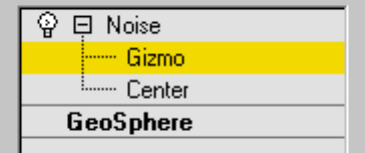
To create terrain effects:
When set for Fractal, the Noise modifier produces a random fractal noise that
creates a variety of topological and terrain effects. You can animate these
effects or use them to model static landscapes and other complex forms.
The following steps assume you begin with a broad object like a multi-segment
box lying on the XY plane.
1Apply the Noise modifier to the object.
2In the Parameters rollout > Noise group, turn on Fractal.
Roughness and Iterations settings are now available.
3Increase Strength on the Z axis and adjust other parameters.
Once you have a base terrain, you can select sub-objects with Edit Mesh
and apply Noise to grow mountains in a smaller region. You can also
apply a second Noise modifier to amplify the first one.
Interface
Modifier Stack
Gizmo/Center You can move, rotate, or scale the gizmo and center
sub-objects to affect the noise. You can also animate the sub-object transforms.
For more information on the stack display, see Modifier Stack on page 7427 .
1506 | Chapter 9 Modifiers
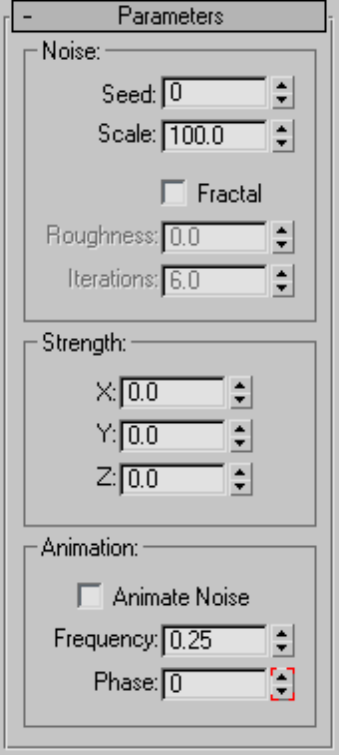
Parameters rollout
Noise group
Controls the appearance of the noise, and thus its effect on the physical
deformations of the object. By default, the controls are inactive until you
change the settings.
Noise Modifier | 1507
Seed Generates a random start point from the number you set. Especially
useful in creating terrain, because each setting can produce a different
configuration.
Scale Sets the size of the noise effect (not strength). Larger values produce
smoother noise, lower values more jagged noise. Default=100.
Fractal Produces a fractal effect based on current settings. Default=off.
If you turn on Fractal, the following options are available:
Roughness Determines the extent of fractal variation. Lower values are less
rough than higher values. Range=0 to 1.0. Default=0.
Iterations Controls the number of iterations (or octaves) used by the fractal
function. Fewer iterations use less fractal energy and generate a smoother
effect. An iteration of 1.0 is the same as turning Fractal off. Range=1.0 to 10.0.
Default=6.0.
Strength group
Controls the magnitude of the noise effect. No noise effect occurs until some
strength is applied.
X, Y, Z Set the strength of the noise effect along each of three axes. Enter a
value for at least one of these axes to produce a noise effect. Default=0.0,0.0,0.0.
Animation group
Controls the shape of the noise effect by overlaying a sine wave for the noise
pattern to follow. This keeps the noise within bounds, dampening random
extremes. When Animate Noise is turned on, these parameters influence the
overall noise effect. However, you can animate Noise and Strength parameters
independently; these do not require Animate Noise to be on during animation
or playback.
Animate Noise Regulates the combined effect of Noise and Strength
parameters. The following parameters adjust the underlying wave.
Frequency Sets the periodicity of the sine wave. Regulates the speed of the
noise effect. Higher frequencies make the noise quiver faster. Lower frequencies
produce a smoother and more gentle noise.
Phase Shifts the start and end points of the underlying wave. By default,
animation keys are set at either end of the active frame range. You can see the
effect of Phase more clearly by editing these positions in Track View. Select
Animate Noise to enable animation playback.
1508 | Chapter 9 Modifiers
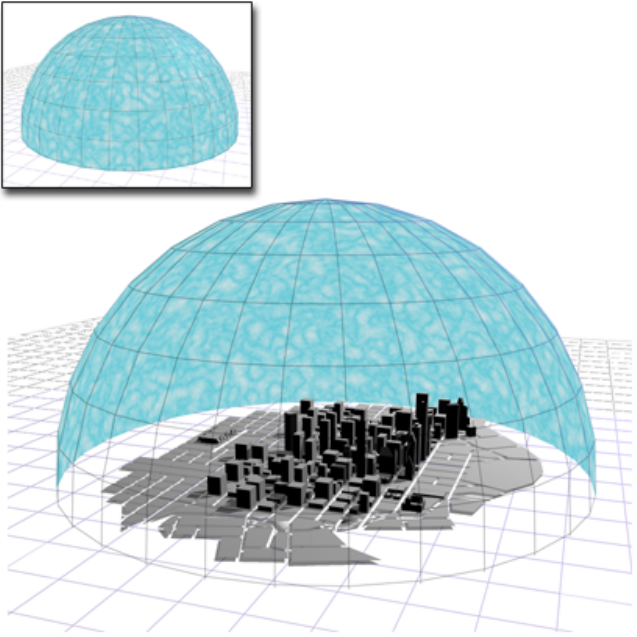
Normal Modifier
Select an object. > Modify panel > Modifier List > Normal
Select an object. > Modifiers menu > Mesh Editing > Normal Modifier
The Normal modifier allows you to unify or flip the normals of an object
without applying an Edit Mesh modifier.
For example, if you wanted to fly inside of a procedural object, such as a sphere
or a cylinder, and wanted to retain control over the radius and number of
segments, you couldn't collapse the object to an Editable Mesh and maintain
the procedural nature of the primitive.
Flipping the normals of a sphere creates a sky dome over a city.
Normal Modifier | 1509
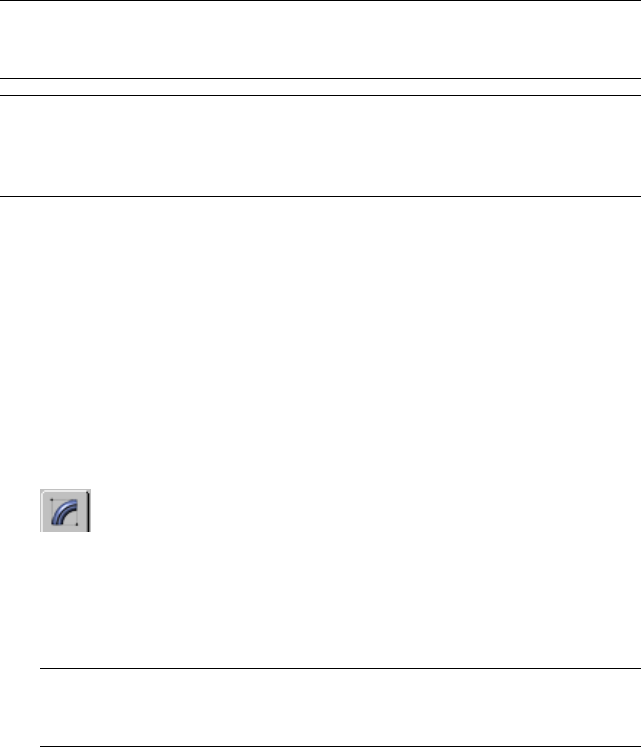
TIP If you are animating the creation of a complex object such as a nested Boolean
or a loft, and you think the operation might result in inconsistent faces, apply
Normal to the result and turn on Unify.
TIP The Lathe modifier sometimes creates an object with normals pointing inward.
Use the Normal modifier with both Unify and Flip turned on to fix "inside-out"
lathe objects. The Normal modifier allows whole-object manipulations of normals
to be performed quickly without using an Edit Mesh modifier.
Patches
Patch objects coming up the modifier stack are not converted to a mesh by
this modifier. A patch object input to the Material modifier retains its patch
definition. Files that contain patch objects with the Material modifier from
previous versions of the software will be converted to meshes to maintain
backward compatibility.
Procedures
To use the normal modifier:
1 Select an object, then on the Modify panel, choose Mesh Editing
> Normal from the Modifier List.
The object appears to turn inside-out, since Flip Normals is on by default.
2If the object has some faces pointing inward and others outward, turn
on Unify Normals to make all the faces point similarly.
TIP To flip or unify normals on portions of objects, convert to Editable Mesh
and select Faces or Polygons. On the Surface Properties rollout in the Normals
group, use the Flip and Unify buttons.
1510 | Chapter 9 Modifiers
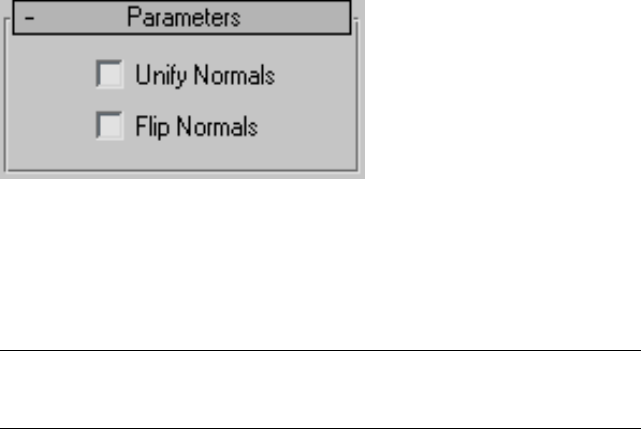
Interface
Unify Normals Unifies the normals of an object by flipping the normals so
that they all point in the same direction, usually outward. This is useful for
restoring an object's faces to their original orientations. Sometimes normals
of scenes that have come into 3ds Max as part of a DWG or DXF file are
irregular, depending on the methods used to create the scene. Use this option
of the modifier to correct them.
NOTE Unify Normals does not work on editable poly on page 2038 objects; before
applying the Normal modifier, convert the model to editable mesh format or apply
a Mesh Select on page 1455 or Turn To Mesh on page 1756 modifier.
Flip Normals Reverses the direction of all the surface normals of the faces of
the selected object or objects. Default=on.
Normalize Spline Modifier
Select a spline object. > Modify panel > Modifier List > Normalize Spl.
Select a spline object. > Modifiers menu > Patch/Spline Editing > Normalize
Spline
Normalize Spline Modifier | 1511
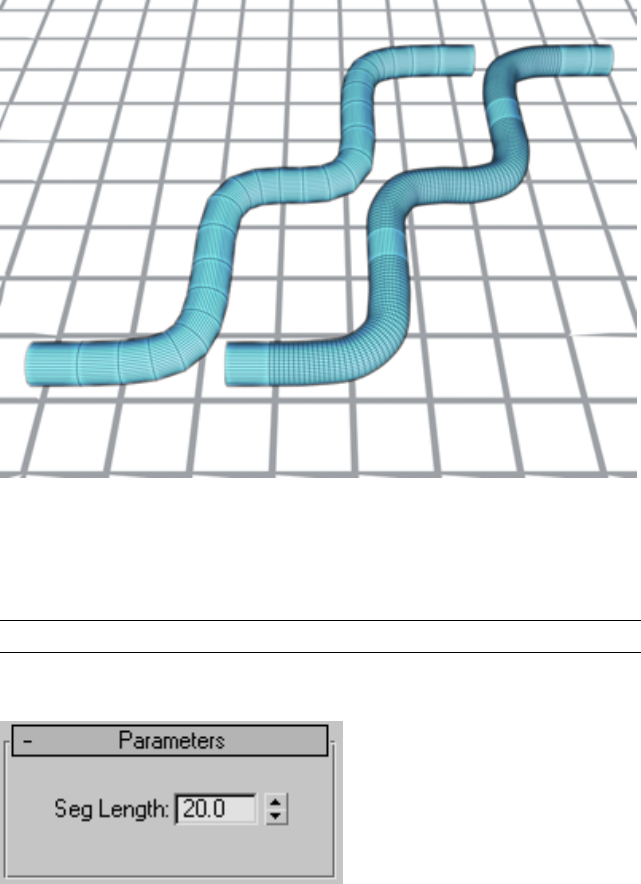
The spline on the left has been normalized.
The Normalize Spline modifier adds new control points in the spline at regular
intervals. Use Normalize Spline to produce splines for motion paths that
require constant velocity.
NOTE This feature is not animatable.
Interface
Seg Length Sets the length of the spline's segments, in 3ds Max units. The
positions of the original vertices are discarded, and vertices are set to regular
intervals. Segment length determines how many control points are added:
1512 | Chapter 9 Modifiers
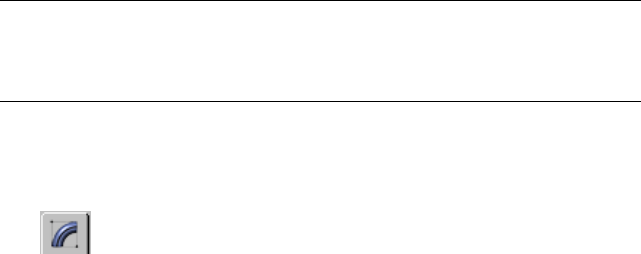
shorter segments result in more control points, longer segments result in fewer.
Default=20.0 units.
NSurf Sel Modifier
Select a NURBS curve or surface object. > Modify panel > Modifier List > NSurf
Sel
Select a NURBS curve or surface object. > Modifiers menu > Selection Modifiers
> NURBS Surface Select
Select a NURBS curve or surface object. > Modifiers menu > NURBS Editing >
Surface Select
The NSurf Sel (NURBS Surface Selection) modifier lets you place a NURBS on
page 2152 sub-object selection on the modifier stack. This lets you modify only
the selected sub-objects. Also, selected curve sub-objects are shape objects that
you can use as paths and motion trajectories.
If a NURBS surface object is nonrelational on page 2219 , NSurf Sel can't select
the sub-object levels Curve, Curve CV, or Point. NURBS surfaces are
nonrelational by default. You can make the surface relational by turning on
Relational Stack on the object's General rollout.
NSurf Sel can select any kind of NURBS sub-objects except imports. Each
sub-object selection is of one particular sub-object level only.
NOTE The NSurf Sel modifier doesn't support copying and pasting selections as
Mesh Select on page 1455 does. Copying and pasting mesh selections is based on
vertex indexes. NURBS selections are based on object IDs, which are unique to
each model.
Procedures
To use the NSurf Sel (NURBS Surface Selection) modifier:
1 With a NURBS object selected in the Modify command panel,
apply NSurf Sel.
This modifier has no controls at the top level.
NSurf Sel Modifier | 1513
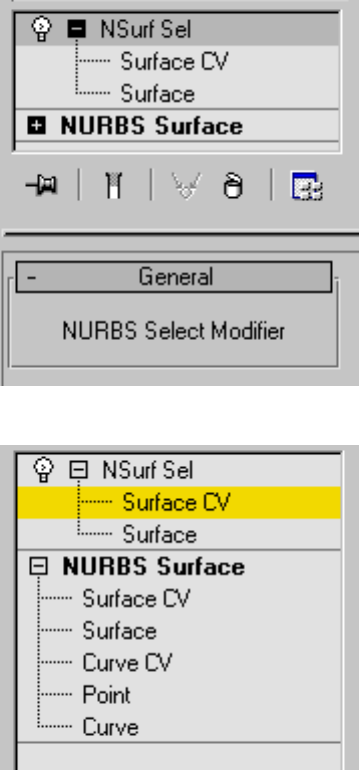
2In the stack display, choose a sub-object level from the list.
NSurf Sel has the same selection controls you see for NURBS surfaces,
except that selecting connected curves or surfaces is not available.
For more information on the stack display, see Modifier Stack on page
7427 .
While applying the modifier, you can also select NURBS sub-objects by
name. Turn on the Keyboard Shortcut Override toggle on page 7646 and
then press the H key. This displays a version of the Selection Floater on
1514 | Chapter 9 Modifiers
page 171 that lists only sub-objects at the current level. Choose one or
more objects in the list, and then click Select.
3Use the selection controls to create a selection set of the chosen sub-object
type.
With NSurf Sel, the selection can be of surface CV or surface sub-objects.
If you turn on Relational Stack for the NURBS object, you can also select
point, curve, and curve CV sub-objects.
4At the Surface CV sub-object level, adjust Soft Selection controls as you
wish. These controls are the same as those in the Soft Selection rollout
on page 2275 for NURBS curves and surfaces, except that the Same Type
Only toggle is absent.
Once you've used the modifier to create the selection, you can apply other
modifiers to it.
Optimize Modifier
Select an object. > Modify panel > Modifier List > Optimize
Select an object. > Modifiers menu > Mesh Editing > Optimize
The Optimize modifier lets you reduce the number of faces and vertices in an
object. This simplifies the geometry and speeds up rendering while maintaining
an acceptable image. A Before/After readout gives you exact feedback on the
reduction as you make each change.
Optimize Modifier | 1515
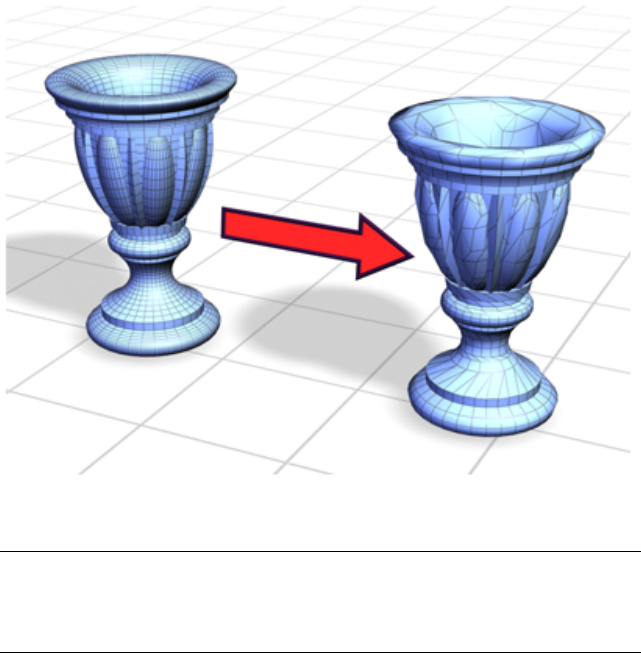
Optimize simplifies a smooth model with a high number of faces without greatly
changing the model’s appearance.
TIP Because Optimize makes decisions based on angles between faces, it's
sometimes best to apply it to selected face sub-objects rather than to an entire
object. Avoid applying Optimize to areas where you want to preserve geometric
detail.
Applying Optimize
When you first apply Optimize, you might not see any change in the viewports.
Adjust the Face Threshold setting to obtain the best optimization. In the Last
Optimize Status group, you can see how the object or faces were optimized.
Watch these values while you adjust the Optimize parameters, until you have
the best possible result.
Setting Level of Detail
Optimize lets you maintain two levels of optimization detail. You might set
a lower optimization level, with fewer faces, to speed up your viewport work,
and a higher level for final output in the renderer. However, you can render
1516 | Chapter 9 Modifiers
at either level. You can also switch to the higher level in a viewport to get an
idea of what the rendered image will look like.
Procedures
To optimize manually:
1Set up two viewports: one wireframe, one smooth shaded.
2Select an object and apply the Optimize modifier.
The Parameters rollout for this modifier appears.
3Turn off Manual Update and then adjust the Face Thresh value. Observe
the result in the viewports.
You can also choose to view the results of the Optimize operation
manually by leaving the Manual Update check box turned on and clicking
the Update button every time you wish to view a result.
4In the Parameters rollout > Last Optimize Status group, notice the
Before/After count for vertices and faces.
5In the Optimize group, vary parameters to continue reducing geometry.
Compare the result in the two viewports against the Before/After count.
To set the level of detail:
1In the Parameters rollout > Level of Detail group, choose Viewports L1.
2Adjust parameters in the Optimize and Preserve groups.
This sets the L1 level of optimization for both the viewport and the
renderer.
3Repeat steps 1 and 2 for Viewports L2, adjusting parameters for a different
optimization.
To use level of detail:
■Switch between L1 and L2 for either Viewports or Renderer.
You see the effect immediately in a smooth shaded viewport. Do a test
rendering to see the effect on the renderer.
The following parameters are stored for each level: Face Threshold, Edge
Threshold, Bias, Max Edge Len, Material Boundaries, and Smooth Boundaries.
Optimize Modifier | 1517
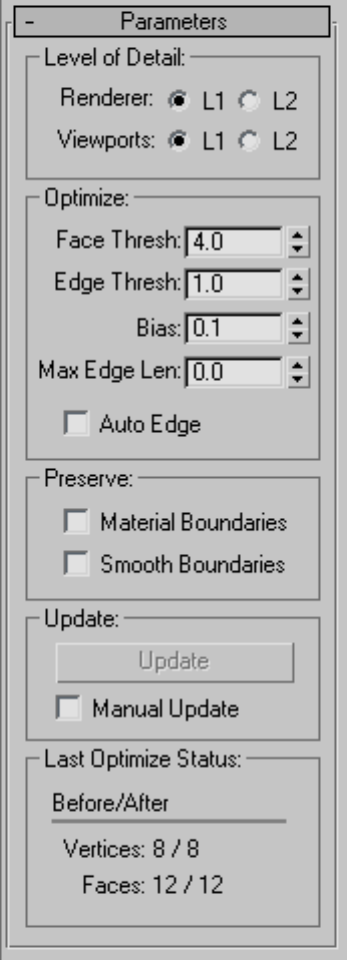
Interface
1518 | Chapter 9 Modifiers
Level of Detail group
Renderer L1, L2 Set the level of display for the default scanline renderer. Use
Viewports L1 and L2 to change the stored optimization level. Default=L1.
Viewports L1, L2 Set the optimization level for both viewport and renderer.
Also toggles the level of display for the viewport. Default=L1.
Optimize group
Adjusts the degree of optimization.
Face Thresh Sets the threshold angle used to determine which faces are
collapsed. Low values produce less optimization but better approximations of
the original shape. Higher values improve optimization, but are more likely
to result in faces that render poorly (see Bias). Default=4.0.
Edge Thresh Sets a different threshold angle for open edges (those that
bound only one face). A low value preserves open edges. At the same time
you can apply a high face threshold to get good optimization. Default=1.0.
Bias Helps eliminate the skinny or degenerate triangles that occur during
optimization, which can cause rendering artifacts. Higher values keeps triangles
from becoming degenerate. The default of 0.1 is enough to eliminate the
skinniest triangles. Range=0.0 to 1.0 (a 0 value turns Bias off).
Max Edge Len Specifies the maximum length, beyond which an edge cannot
be stretched when optimized. When Max Edge Len is 0, it has no effect. Any
value greater than 0 specifies the maximum length of the edges. Default=0.0.
Along with Bias, this control helps you avoid creating long skinny faces while
optimizing.
Auto Edge Turns edges on and off following optimization. Turns on any
open edges. Turns off any edges between faces whose normals are within the
face threshold; such edges beyond the threshold are not turned on. Default=off.
Preserve group
Maintains clean separation at the face level between material and smoothness
boundaries.
Material Boundaries Prevents face collapse across material boundaries.
Default=off.
Smooth Boundaries Optimizes an object and maintain its smoothing. When
turned on, allows only faces that share at least one smoothing group to
collapse. Default=off.
Optimize Modifier | 1519
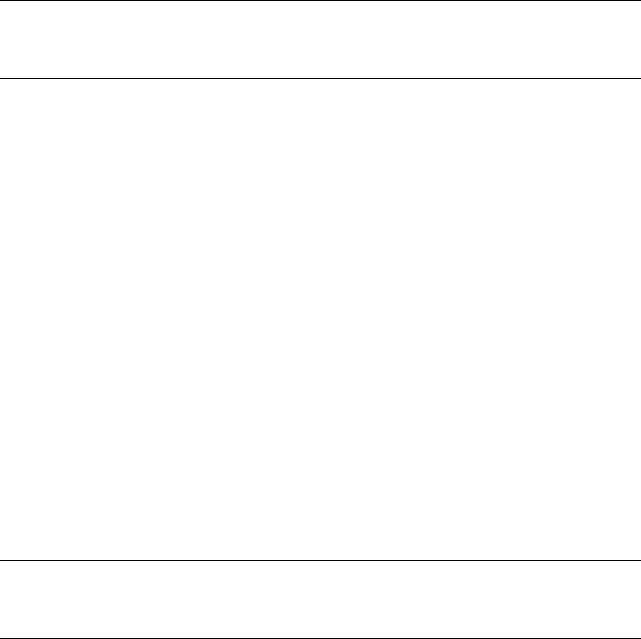
Update group
Update Updates the viewports with the current optimization settings.
Available only when Manual Update is turned on.
Manual Update Enables the Update button. When turned off, Optimize
works as it does by default, updating the viewport display dynamically.
NOTE When using Manual Update, if you make any changes that cause the
reevaluation of the stack, the existing optimization display disappears. Click the
Update button again to restore it.
The Renderer ignores the optimization display in the viewport, using the
Optimize settings, regardless of the state of the Manual Update.
Last Optimize Status group
Displays numerical results of optimization with exact before-and-after counts
for vertices and faces.
Patch Select Modifier
Make a selection. > Modify panel > Modifier List > Patch Select
Make a selection. > Modifiers menu > Selection Modifiers > Patch Select
The Patch Select modifier lets you pass a sub-object selection up the stack to
subsequent modifiers. It provides a superset of the selection functions available
in the Edit Patch modifier on page 1290 . You can select vertices, edges, patches,
and elements. You can also change the selection from sub-object level to object
level.
NOTE When you apply the Patch Select modifier and then go to any sub-object
level, the select-and-transform buttons in the toolbar are unavailable, and the
Select Object button is automatically activated.
Using XForm Modifiers to Animate a Patch Selection
When you apply a Patch Select modifier, there are no animation controllers
assigned to the sub-object selection. This means that the selection has no way
to "carry" the transform information needed for animation.
To animate a sub-object selection using Patch Select, apply either an XForm
or Linked XForm modifier to the selection. These modifiers provide the
1520 | Chapter 9 Modifiers
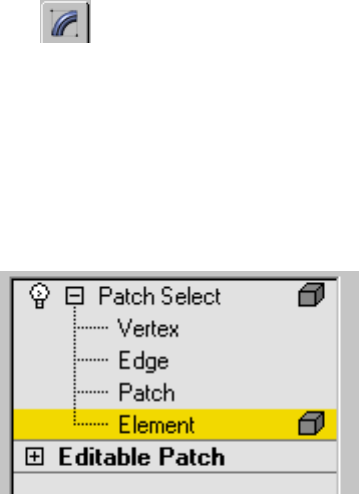
necessary controllers for animating the effects of transforms. In a sense, they
give "whole-object status" to the sub-object selection.
■XForm on page 1922
Animates transforms directly on a sub-object selection. Creates a gizmo
and center for the sub-object selection. You can animate both, with the
center acting as a pivot point for the selection.
■Linked XForm on page 1440
Lets you choose another object to control the animation. The sub-object
selection is linked to the "control object." When you transform the control
object, the sub-object selection follows accordingly.
Procedures
To use the patch select modifier:
1Create or select a patch object.
2 Go to the Modify panel and choose Patch Select from the modifier
list.
3Select vertices, handles, edges, patches, or elements.
4Add another modifier to affect only the selection from step 3.
Interface
Modifier Stack
Vertex Selects vertices.
Handle Selects handles.
Patch Select Modifier | 1521
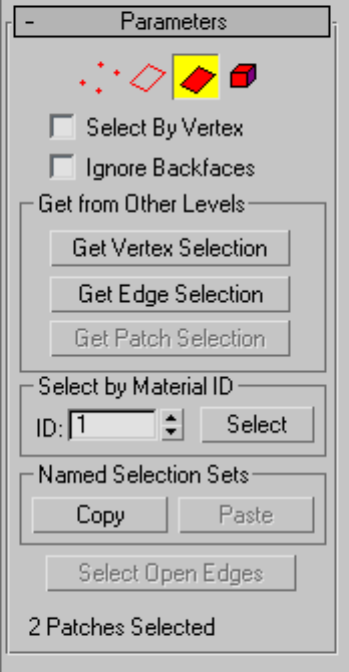
Edge Selects edges.
Patch Selects patches.
Element Selects elements.
For more information on the stack display, see Modifier Stack on page 7427 .
Parameters rollout
Provides buttons for turning different sub-object modes on and off, working
with named selections and handles, display settings, and information about
selected entities.
1522 | Chapter 9 Modifiers
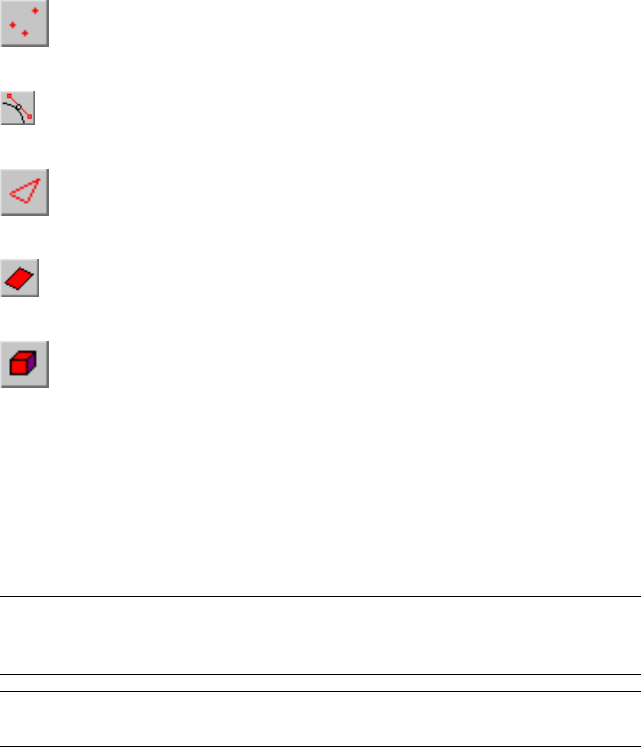
The icons at the top of the Selection rollout let you specify the method of face
selection. Clicking a button here is the same as selecting a sub-object type in
the modifier stack. Click the button again to turn it off and return to the object
selection level.
Vertex Selects a vertex beneath the cursor; region selection selects
vertices within the region.
Handle Selects a handle beneath the cursor; region selection selects
multiple handles within the region.
Edge Selects an edge beneath the cursor; region selection selects
multiple edges within the region.
Patch Selects a patch beneath the cursor; region selection selects
multiple patches within the region.
Element Selects all contiguous faces in an object; region selection
selects the same.
Select By Vertex Selects any sub-objects at the current level that use a vertex
you click. Applies to all sub-object levels except Vertex. Also works with Region
Select.
Ignore Backfaces Selects only those edges, patches, or elements whose
normals make them visible in the viewport. When turned off (the default),
selection includes all sub-objects, regardless of the direction of their normals.
NOTE The state of the Backface Cull setting in the Display panel doesn't affect
sub-object selection. Thus, if Ignore Backfacing is turned off, you can select
sub-objects even if you can't see them.
NOTE The state of the Ignore Backfaces check box also affects edge selection at
the Edge sub-object selection level.
Get from Other Levels group
Applies selections from one sub-object level to another.
Patch Select Modifier | 1523

Get Vertex Selection Selects edges, patches, or elements based on the last
vertex selection. The selection is added to the current selection. Available only
when Vertex is not the current sub-object level.
Get Edge Selection Selects vertices, patches, or elements based on the last
edge selection. Selects those vertices, patches, or elements that contain the
edge. Available only when Edge is not the current sub-object level.
Get Patch Selection Selects vertices, edges, or elements based on the last
patch selection. This selection is added to the current selection. Available only
when Patch is not the current sub-object level.
Select by Material ID group
Selects faces based on their material ID.
ID Set the spinner to the ID number you want to select, and then click the
Select button. Press Ctrl while clicking to add to the current selection, or press
Alt to remove from the current selection.
Named Selection Sets group
These functions are primarily for copying named selection sets on page 179
of sub-objects between similar objects, and between comparable modifiers
and editable objects. For example, you can apply a patch select modifier to a
sphere, create a named selection set of edges, and then copy the selection to
a different sphere that's been converted to an editable patch object. You can
even copy the selection set to a different type of object, because the selection
is identified by the entities' ID numbers.
The standard procedure is to create a selection set, name it, and then use Copy
to duplicate it into the copy buffer. Next, select a different object and/or
modifier, go to the same sub-object level as you were in when you copied the
set, and click Paste.
NOTE Because sub-object ID numbers vary from object to object, the results of
copying named selection sets between different objects can be unexpected. For
example, if the buffered set contains only entities numbered higher than any that
exist in the target object, no entities will be selected when the set is pasted.
Copy Places a named selection into the copy buffer.
Paste Pastes a named selection from the copy buffer.
1524 | Chapter 9 Modifiers

Select Open Edges Selects all edges with only one face. In most objects, this
will show you where missing patches exist. Available only at the Edge
sub-object level.
Selection Info
At the bottom of the Patch Select Parameters rollout is a text display giving
you information about the current selection. If 0 or more than one sub-object
is selected, the text gives the number and type selected. If one sub-object is
selected, the text gives the ID number and type of the selected item.
NOTE When the current sub-object type is Patch or Element, selection information
is given in Patches.
Soft Selection rollout
See Soft Selection Rollout on page 1926 for information on the Soft Selection
rollout settings.
PatchDeform Modifier
Select an object. > Modify panel > Modifiers List > Object-Space Modifiers >
PatchDeform
Select an object. > Modifiers menu > Animation Modifiers > Patch Deform
The PatchDeform modifier deforms an object based on the contours of a patch
object. This modifier works similarly to the PathDeform modifier on page
1528 , but uses a quad-based patch object instead of a spline shape or NURBS curve
path.
To use the PatchDeform modifier, apply it to the object you want to deform,
click the Pick Patch button, and then select a patch object. Deform the object
by manipulating the patch object or adjusting the various controls in the
Patch Deform panel.
Not all objects can be used with PatchDeform. Objects that are valid
PatchDeform targets include: Plane, Cylinder, Cone and Torus.
This modifier is also similar to the SurfDeform modifier on page 1707 , except
that it uses a patch surface instead of a NURBS Point or CV surface.
There's also a world-space version of the PatchDeform modifier. See
PatchDeform (WSM) on page 1123 . Generally, the PatchDeform object-space
modifier leaves the object in place while moving the patch to the object, while
PatchDeform Modifier | 1525
the PatchDeform world-space modifier leaves the patch in place while moving
the object to the patch. Also, the WSM version has a Move to Patch button,
while the object-space version does not.
Procedures
To use the PatchDeform modifier:
1Select an object.
2Apply PatchDeform.
3On the Parameters rollout, click Pick Patch.
4Select a patch object.
Deform the object by adjusting the controls in the Patch Deform panel
and by manipulating the patch object.
Interface
Modifier Stack
Gizmo At this sub-object level, you can transform and animate the gizmo
like any other object, altering the effect of the modifier. The PatchDeform
gizmo is a representation of the deforming patch object, so transforming it
determines which part of the patch affects the modified object.
1526 | Chapter 9 Modifiers
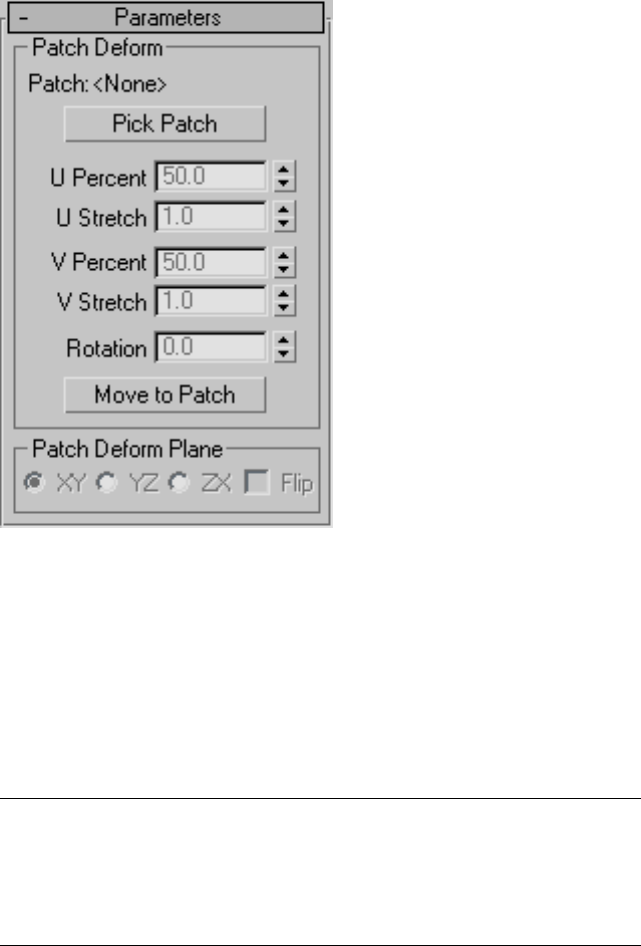
Parameters rollout
Patch Deform group
Provides controls that let you pick the patch and adjust the object's position
and deformation along the gizmo copy of the patch.
Patch Displays the name of the selected patch object.
Pick Patch Click this button, and then select the patch object you want to
use for the deformation. A gizmo is created for the object that matches the
patch. Once you assign the patch gizmo, you can adjust the deformation using
the remaining controls in this rollout.
NOTE Patch Deform can be used only with a rectangular quad patch form. The
software makes no distinction between quad-style patches and certain primitive
meshes. Examples of suitable patches are the primitive quad patch object on page
1984 , the primitive cylinder on page 364 , and the primitive torus on page 370 .
(The cylinder actually has tri-patches at each end, but since they are at the end of
the list of patches, PatchDeform just ignores these extra faces.)
PatchDeform Modifier | 1527
U Percent Moves the object along the U (horizontal) axis of the gizmo patch,
based on a percentage of the U distance. This spinner defaults to a setting of
50 percent, which places the object at the center of the gizmo patch. A setting
of 0 percent places the object at the left edge of the gizmo patch, as seen from
the viewport where the patch was created.
U Stretch Scales the object along the U (horizontal) axis of the gizmo patch.
V Percent Moves the object along the V (vertical) axis of the gizmo patch,
based on a percentage of the V distance. A setting of 0 percent places the
object at the bottom of the gizmo patch.
V Stretch Scales the object along the V (vertical) axis of the gizmo patch.
Rotation Rotates the modified object with respect to the gizmo patch.
Move To Patch Clicking this button moves the object from its original
position to the patch object you are using for deformation. This button is only
available with the PatchDeform (WSM).
Patch Deform Plane group
XY/YZ/ZX Choose a two-axis plane of the object to make parallel with the
XY plane of the gizmo patch.
Flip Reverses the gizmo direction.
PathDeform Modifier
Select an object. > Modify panel > Modifier List > Object–Space Modifiers >
PathDeform
Select an object. > Modifiers menu > Animation Modifiers > Path Deform
The PathDeform modifier deforms an object using a spline or NURBS curve
as a path. You can move and stretch the object along the path, and rotate and
twist it about the path. There's also a world-space modifier version. See
PathDeform (WSM) on page 1123 .
1528 | Chapter 9 Modifiers
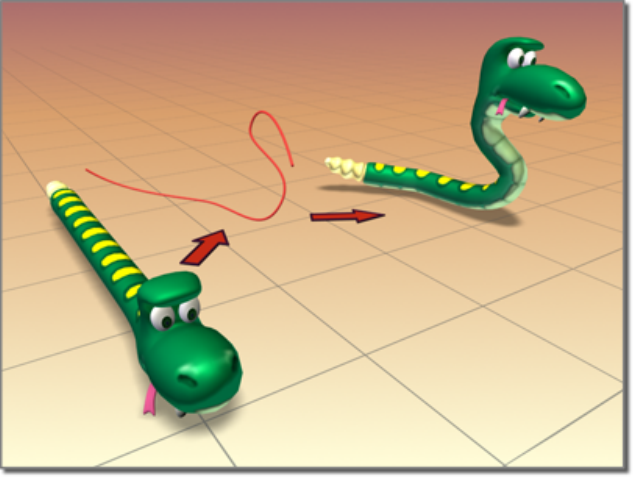
PathDeform creates a wiggle for the snake.
Using a Path to Deform an Object
Generally, you use the PathDeform modifier when you want to keep an object
in place while deforming to a path. Use the PathDeform world-space modifier
when you want to move an object to a path while keeping the path in the
same world space.
The PathDeform (WSM) modifier replaces the space-warp version that shipped
with previous versions of 3ds Max, and is incompatible with previous versions.
See PathDeform (WSM) on page 1123 for details on how to fix incompatibilities
from the previous version.
To use the PathDeform modifier, you apply it, then click the Pick Path button
and select a shape or curve consisting of a single open or closed spline. Once
the object is assigned to the path, you can adjust the parameters to deform
or animate the object along a gizmo copy of the path.
PathDeform Modifier | 1529
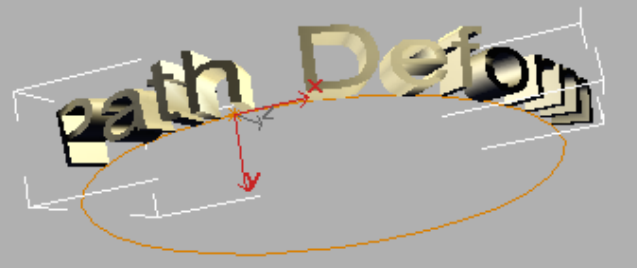
Procedures
To use the PathDeform modifier:
1Select an object.
2Apply PathDeform.
3On the Parameters rollout, click Pick Path.
4Select a spline or NURBS curve.
Deform the object by adjusting the various controls in the Path Deform
panel and by editing the path object.
Example: To use the PathDeform modifier to curve text:
1In the Top viewport, create a circle with a radius of 100 units.
2In the Front viewport, create a text shape with six or seven letters, and a
size of 25. (You can use the default " MAX Text".)
3Apply an Extrude modifier on page 1377 to the text shape and set Amount
to -5.0.
4On the main toolbar, set the Reference Coordinate System to Local.
Looking at the axis tripod for the extruded text object, you can see that
its Z axis runs from back to front, relative to world space.
5Apply a PathDeform object-space modifier to the text object, click the
Pick Path button, and then select the circle.
A circular gizmo is displayed. The circle runs through the local Z axis of
the text object. Because of its orientation, its effect is minimal, but you
can see a slight wedge-shaped deformation from the top view.
1530 | Chapter 9 Modifiers
6In the Path Deform Axis group, choose the Y option, and then the X
option.
The circle gizmo rotates to run through the specified axes, deforming the
text object differently with each change.
7Adjust the Percent spinner to view its effect, and then set it to 0. Try the
same with Stretch, Rotation, and Twist, and then restore them to their
original values. (Tip: Use the Ctrl key with Twist to amplify the effect.)
8Turn Flip on and off to switch the direction of the path.
9In the stack display, choose the Gizmo sub-object level, and move the
gizmo path around.
The text object is further deformed by its relative position to the gizmo.
10 In the stack display, turn off sub-object selection by selecting the original
circle shape.
11 Adjust the circle's radius.
The deformation of the text object changes because its gizmo is an
instance of the shape object.
Interface
Modifier Stack
Gizmo At this sub-object level, you can transform and animate the gizmo
like any other object, altering the effect of the modifier. The PathDeform
gizmo is a representation of the deforming path object, so transforming it
determines which part of the path affects the modified object.
PathDeform Modifier | 1531
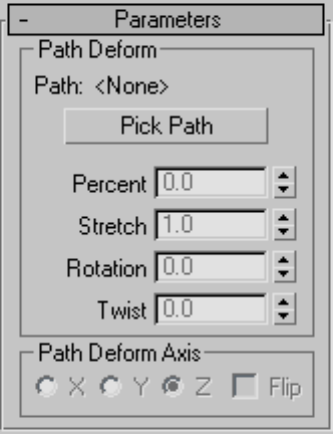
Parameters rollout
Path Deform group
Provides controls that let you pick a path and adjust an object's position and
deformation along the path.
Path Displays the name of the selected path object.
Pick Path Click this button and then select a spline or NURBS curve to use
as the path. The gizmo that appears is shaped like the path and is aligned with
the local Z axis of the object. Once you assign the path, you can adjust the
deformation of the object using the remaining controls in this rollout. The
path you pick should contain a single, open or closed curve. If you use a path
object consisting of multiple curves, only the first one is used.
Percent Moves the object along the gizmo path based on a percentage of
the path length.
Stretch Scales the object along the gizmo path, using the object's pivot point
as the base of the scale.
Rotation Rotates the object about the gizmo path.
1532 | Chapter 9 Modifiers

Twist Twists the object about the path. The twist angle is based on the
rotation of one end of the overall length of the path. Typically, the deformed
object takes up only a portion of the path, so the effect can be subtle.
Path Deform Axis group
X/Y/Z Choose one to rotate the gizmo path to align with a specified local
axis of the object.
Flip Reverses the gizmo path 180 degrees about the specified axis.
Point Cache Modifier
Select an object. > Modify panel > Modifier List > Object–Space Modifiers >
Point Cache
Select an object. > Modifiers menu > Cache Tools > Point Cache
The Point Cache modifier lets you store modifier and sub-object animation
to a disk file that records only changes in vertex positions, and then play back
the animation using the information in the disk file instead of the modifier
keyframes. This is useful when the computation required for vertex animation
becomes so excessive that it causes animation playback to run slowly or drop
frames.
Another use for this modifier is to apply the same animation to a number of
objects, varying the Start Time and Strength settings for each so they don't
all move identically.
The Point Cache modifier is also available in a world-space version, for which
usage is the same.
New Features in Point Cache
New features in Point Cache modifier include:
■You can now save animation files in XML and MC formats for greater
compatibility with other applications, such as Autodesk Maya, as well as
the legacy PC2 format.
■When recording to XML, you can save each animation frame in a separate
file.
Point Cache Modifier | 1533
Cache files for large meshes and long animations can be very large. Saving
as a file per frame lets you manage data more easily and replace single
frames if you find errors.
Compatibility with Autodesk Maya
Following is a suggested workflow for using Point Cache for working on an
animation project in both 3ds Max and Autodesk Maya:
1Create a deforming mesh (Skin, Cloth, etc.).
2Apply the Point Cache modifier.
3Save the cache in XML format with referenced MC files.
4Save the mesh in FBX format.
5Bring the mesh into Maya.
6In Maya, load the cache data onto the onto the mesh using the XML file
to load the referenced MC files.
7Modify the animation in Maya and save it, overwriting the XML and MC
files.
In 3ds Max, use the Point Cache > Reload command; this updates the
animation to that saved from Maya.
Special Features in Point Cache
Both versions of the Point Cache modifier provide enhanced animation
capabilities, including:
■Adjustable playback ranges and a playback graph, to animate which cache
frame is played back. This lets you load a cache and then animate it, slowing
down, stopping, reversing, etc.
■Nth-frame sampling, so you can sample every few frames to save disk space
if sampling every frame is unnecessary, or record multiple samples per
frame for improved motion blurring.
■The "strength" is adjustable in Absolute mode, so you can easily blend the
cache with what is below in the stack.
■Improved cache file management.
■Pre-loaded caches to speed up playback.
1534 | Chapter 9 Modifiers

Procedures
To use the Point Cache modifier:
1Use one or more modifiers to animate an object. For example, you might
apply a Bend modifier on page 1139 , and then set keyframes for the Angle
parameter to make the object bend back and forth.
2Click Play Animation.
If the animation is a good candidate for caching, the playback will drop
many frames with Real Time Playback turned on, and will run slowly
with Real Time Playback turned off.
3 From the Modify panel > Modifier List, choose Object-Space
Modifiers > Point Cache.
4On the Parameters rollout > Record group, set values for Start Time and
End Time.
5If you plan to render the cached animation using motion blur, decrease
the Sample Rate setting.
6Click the Record button, and use the Save Cache dialog to specify a cache
file. To export the animation to another program, such as Autodesk Maya,
use the XML file format; otherwise, use the PC2 file format.
The software records the animation to the cache file. When finished, the
cache file name appears in the Cache File group.
7In the Record group, click Disable Modifiers Below.
This turns off all the object's modifiers below Point Cache so that only
the cached vertex animation will appear when you play back the
animation.
8Click Play Animation again.
This time the animation plays back quickly and smoothly.
Point Cache Modifier | 1535

Interface
Parameters rollout
1536 | Chapter 9 Modifiers
Cache File group
Contains settings for recording vertex animation.
[file name] After you specify or load a cache file, its name appears in this
field.
New Creates a new, empty cache file. After setting a new file, use Record to
create the cache data.
You can save the file in either of two formats:
■XML:Saves the basic cache information in an XML file, and the animation
data in one or more MC files (The XML file includes references to the MC
files). The modifier uses multiple MC files if you set the Record group
option to One File Per Frame. When recording multiple MC files, the
modifier gives them the name [file name]Frame[frame number}.mc; for
example, Cylinder01Frame10.mc. If you set a non-integer value for Sample
Rate, the modifier appends the sub-frame cache file names with Tick[tick
number].
■PC2:Saves all cache information and data in a single PC2 file. When you
use this format, the One File Per Frame option is unavailable.
Load Loads a vertex animation from a cache file on disk into the Point Cache
modifier. If the number of vertices in the cache does not match the number
of vertices in the object, the Cache Info group reports an error, and the
animation doesn’t take effect.
Load supports these file formats: XML, PC2, PTS.
Unload Temporarily frees the current cache file, so it can be edited or deleted
externally.
Reload Reopens the current cache file, if previously unloaded.
Cache Info group
Displays cache statistics in read-only format, including the number of files,
point count, evaluations (number of samples), sample rate, start and end
frames, and errors, if any.
Record group
Contains settings for recording cached animation.
Point Cache Modifier | 1537

One File/One File Per Frame Choose whether to save the cache in a single
file, or in a separate file for each frame of recorded animation. The latter option
is available only when using the XML file format.
Start Frame Sets the first frame for recording the vertex animation.
Default=first frame of the active time segment.
Using decimal fractions lets you start at a sub-frame setting when using a
Frame:Ticks time display.
End Frame Sets the last frame for recording the vertex animation. Default=last
frame of the active time segment.
Using decimal fractions lets you start at a sub-frame setting when using a
Frame:Ticks time display.
Sample Rate Sets the number of frames between each recorded sample.
When rendering with motion blur, which uses sub-frame sampling, decrease
this value. Default=1.0.
At the default value of 1.0, Point Cache records one sample per frame.
Increasing the value causes a sample to be recorded every Nth frame. For
example, a value of 10.0 records every tenth frame. Decreasing the value causes
multiple samples to be recorded for each frame. For example, if you set Sample
Rate to 0.1, Point Cache records 10 samples per frame at evenly spaced
intervals.
Record Stores the vertex animation to a disk file. If no cache file is specified,
or the specified file doesn't exist, activates the Save Points dialog, which lets
you specify a path and file name for the cache file. Click Save to record the
file, and then load it into the Point Cache modifier, ready for playback.
TIP To change the path or file name, use Cache File group > New and specify a
different cache file.
Enable Modifiers Below Turns on all stack modifiers below the Point Cache
modifier. Use this when you want to change modifier settings.
Disable Modifiers Below Turns off all the object's stack modifiers below Point
Cache so that only the cached vertex animation appears when you play back
the animation.
Load Type group
These options apply only to PC2 and PTS files; when the cache file type is
XML they are unavailable.
1538 | Chapter 9 Modifiers

Local The method the modifier uses to load the cache file. The options are:
■Stream Keeps the cache file open for fast access, but loads only a single
frame at a time to conserve memory. This is the default mode.
■Per-Sample Opens the cache file, reads a single frame, and then
immediately closes the file. This is slower than the Stream method, but is
useful if many users are reading/writing the same set of cache files since
the cache files won't be locked open as you read from them.
■Pre-Load Loads the entire cache file into memory for fast access, and
then closes the file. This is particularly useful in networked situations, or
when a few cache files are used by many objects in one scene. In the latter
case, using this option prevents each object from thrashing the disk on
playback.
Be conservative in using this, as it can consume a great deal of memory.
However, if one cache file is used by several objects, the cache is loaded
into memory only once.
Slave These options apply if 3ds Max is running as a network-rendering
client; see the preceding for details. In this situation, only Per-Sample and
Pre-Load are available, and the default option is Per-Sample, so the clients
don't lock files.
[label] This read-only field displays the size of the pre-loaded data when
Local is set to Pre-Load.
Playback Options group
Strength Affects the motion relative to the original animation. Applies only
when Relative Offset is on. Default=1.0. Range=-10.0 to 10.0.
At 1.0, the animation plays back the same as recorded. With strengths between
0.0 and 1.0, the animation is relatively restrained. At strengths greater than
1, the animation is exaggerated. With negative Strength settings, the motion
is reversed.
Relative Offset Enables offsetting the animated vertex positions relative to
their positions as recorded, based on the Strength setting. Default=off.
NOTE When you turn on Relative Offset and play back a cached animation with
the modifiers turned on, the cached vertex positions are calculated relative to their
positions as calculated by the modifiers. For example, if you record a Bend
animation to a cache file, and then play it back with both Relative Offset and the
Bend modifier on and Strength=1.0, all vertex positions are doubled, resulting in
exaggerated motion.
Point Cache Modifier | 1539
Apply To Whole Object When off, only the active vertex selection is
animated. In this case, for the cache animation to be visible, the selection
must include at least some of the originally animated vertices.
Playback Type group
Playback Type Specifies how playback occurs:
■Original Range Plays back the cache over the range it was originally
recorded, so the animation will always be the same as the original.
■Custom Start Plays back the cache from a custom start time, set by Start
Frame, but the animation length and playback speed will be the same as
the original animation.
■Custom Range Lets you set start and end frames within which the current
cache plays back. Using a range that is smaller than the original record
range plays the cache back faster, while specifying a larger range plays the
cache back slower.
■Playback Graph Lets you animate which cache frame is played at any
given time.
For example, if you record a cache from frames 0 to 100 and then want it
to play back twice as fast forward and then in reverse, choose this option,
turn on Auto Key, set the Frame parameter to 0.0 at frame 0, 100.0 at frame
50, and then back to 0.0 at frame 100. The function curve of this parameter
in Track View shows how the cache is played back. Animating the Frame
value lets you achieve unusual effects such as slowing a cache down over
time, creating a ping-pong effect during playback, etc.
Start Frame The frame number at which the cached animation starts playing
back. Using decimal fractions lets you start at a sub-frame setting when using
a Frame:Ticks time display. Available only when Playback Type is set to Custom
Start or Custom Range. Default=0.0.
End Frame The frame number at which the cached animation starts playing
back. Using decimal fractions lets you start at a sub-frame setting when using
a Frame:Ticks time display. Available only when Playback Type is set to Custom
Range. Default=0.0.
Frame Lets you animate playback of the cache; for details, see Playback
Graph, above.
Clamp Graph Controls what gets loaded when the Playback Graph frame is
out of the original recorded range.
1540 | Chapter 9 Modifiers
Take an example in which the playback frame is set to 105, but the original
cache was recorded over frames 0-100. With Clamp Graph on, the loaded
frame will be 100. If it's off (the default), the cache will "wrap around" and
load frame 5.
This lets you loop caches more easily. In the above example, you could simply
have a two-key playback graph. The first key would be at frame 0 with a value
of 0.0, and the second would be at frame 100 with a value of 100.0. You would
then set the out-of-range type on page 3523 for the Frame parameter (Playback
Frame in Track View) to Linear, and the cache would loop back smoothly to
the beginning at frame 101.
Poly Select Modifier
Make a selection. > Modify panel > Modifier List > Poly Select
Make a selection. > Modifiers menu > Selection Modifiers > Poly Select
The Poly Select modifier lets you pass a sub-object selection up the stack to
subsequent modifiers. It provides a superset of the selection functions available
in Editable Poly on page 2038 . You can select vertices, edges, borders, polygons,
and elements. You can change the selection from sub-object level to object
level.
When you apply the Poly Select modifier and then go to any sub-object level,
the select-and-transform buttons in the toolbar are unavailable, and the Select
Object button is automatically activated.
Using XForm Modifiers to Animate a Poly Selection
When you apply a Poly Select modifier, there are no animation controllers
assigned to the sub-object selection. This means that the selection has no way
to "carry" the transform information needed for animation.
To animate a sub-object selection using Poly Select, apply either an XForm or
Linked XForm modifier to the selection. These modifiers provide the necessary
controllers for animating the effects of transforms. In a sense, they give
"whole-object status" to the sub-object selection.
■XForm on page 1922
Animates transforms directly on a sub-object selection. Creates a gizmo
and center for the sub-object selection. You can animate both, with the
center acting as a pivot point for the selection.
■Linked XForm on page 1440
Poly Select Modifier | 1541

Lets you choose another object to control the animation. The sub-object
selection is linked to the "control object." When you transform the control
object, the sub-object selection follows accordingly.
Procedures
To use the Poly Select modifier:
1Create or select an object.
NOTE Applying a Poly Select modifier to an object other than a polymesh
type will convert the object to a polymesh object. If you want more control
over the conversion, add a Turn To Poly modifier on page 1761 before applying
the Poly Select modifier. The Turn To Poly modifier provides conversion
options that aren't available with the Poly Select modifier.
2Apply the Poly Select modifier.
3Select vertices, faces, or polygons.
4Add another modifier to affect only the selection from step 3.
1542 | Chapter 9 Modifiers
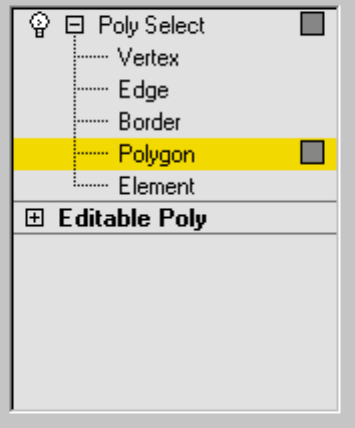
Interface
Modifier Stack
Vertex Selects vertices.
Edge Selects edges.
Border Selects borders.
Polygon Selects polygons.
Element Selects elements.
For more information on the stack display, see Modifier Stack on page 7427 .
Poly Select Modifier | 1543
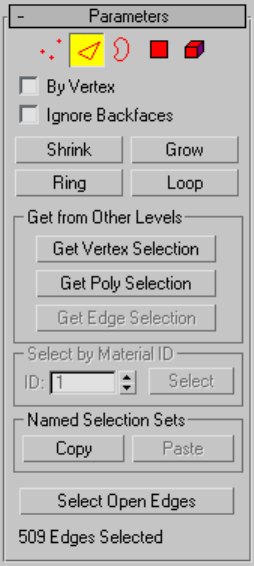
Parameters rollout
Provides buttons for accessing different sub-object levels, working with named
selections and handles, display settings, and information about selected
entities.
The icons at the top of the Selection rollout let you specify the method of face
selection.
Clicking a button here is the same as choosing a sub-object type in the modifier
stack. Click the button again to turn it off and return to the Object selection
level.
1544 | Chapter 9 Modifiers
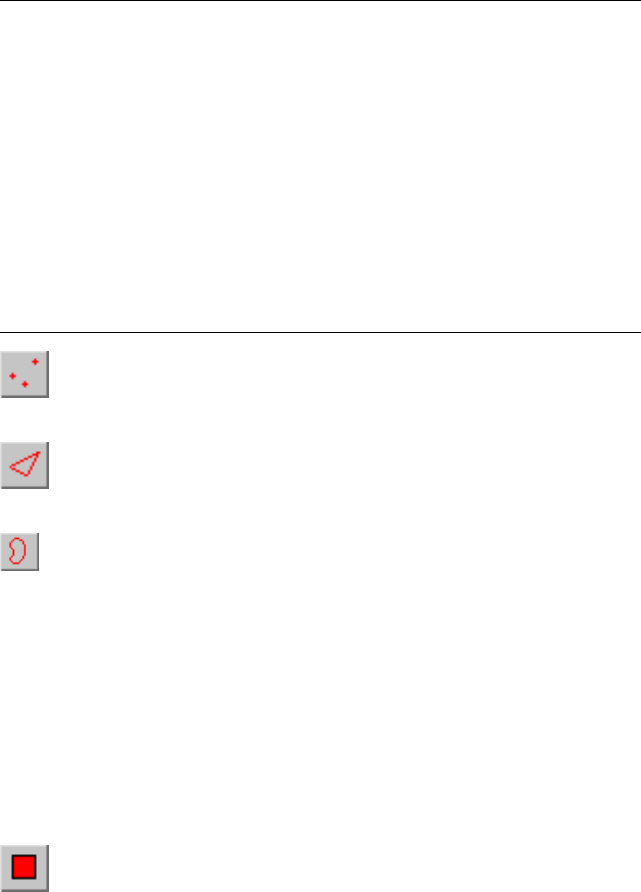
NOTE You can convert sub-object selections in two different ways with the use
of the Ctrl and Shift keys:
■Clicking a sub-object button in the Selection rollout with Ctrl held down
converts the current selection to the new level, selecting all sub-objects in
the new level that touch the previous selection. For example, if you select
a vertex, and then Ctrl+click the Polygon button, all polygons that use that
vertex are selected.
■To convert the selection to only sub-objects all of whose source components
are originally selected, hold down both Ctrl and Shift as you change the
level. For example, if you convert a vertex selection to a polygon selection
with Ctrl+Shift+click, the resultant selection includes only those polygons
all of whose vertices were originally selected.
Vertex Selects a vertex beneath the cursor; region selection selects
vertices within the region.
Edge Selects a polygon edge beneath the cursor; region selection selects
multiple edges within the region.
Border Turns on Border sub-object mode, which lets you select an area
on a mesh that can generally be described as a hole. Areas like this are usually
sequences of edges with faces on only one side. For example, a box doesn't
have a border, but the Teapot object has several of them: on the lid, on the
body, on the spout, and two on the handle. If you create a cylinder, then
delete the top face, the top row of edges forms a border.
When the Border sub-object level is active, you can't select edges that aren't
on borders. Clicking a single edge on a border selects that whole border.
Borders can be capped (either in editable poly or by applying the cap holes
modifier). They can also be connected to another object (compound object
connect).
Polygon Selects all coplanar polygons beneath the cursor. Usually, a
polygon is the area you see within the visible wire edges. Region selection
selects multiple polygons within the region.
Poly Select Modifier | 1545
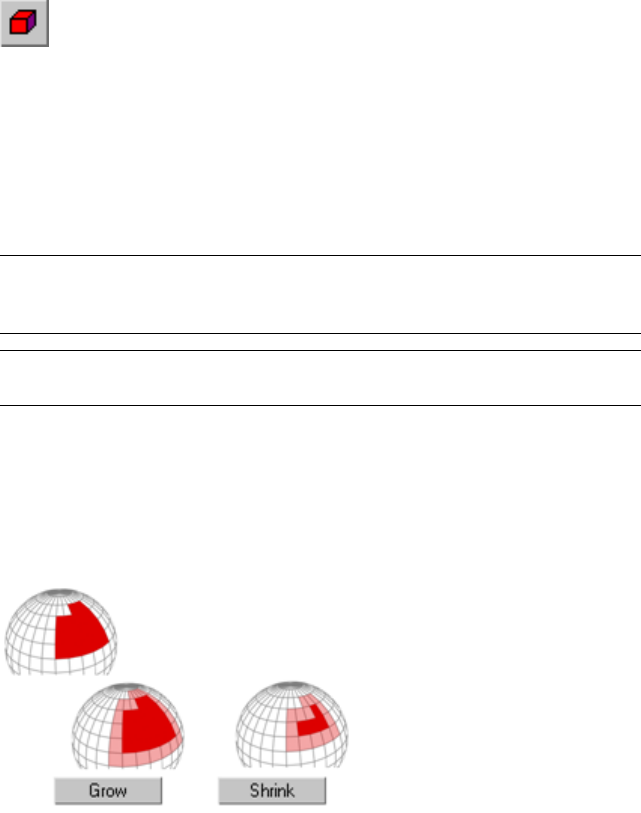
Element Selects all contiguous polygons in an object; region selection
selects the same.
By Vertex Selects any sub-objects at the current level that use a vertex you
click. Applies to all sub-object levels except Vertex. Also works with Region
Select.
Ignore Backfaces Selecting sub-objects selects only those whose normals
make them visible in the viewport. When turned off (the default), selection
includes all sub-objects, regardless of the direction of their normals.
NOTE The state of the Display properties on page 124 > Backface Cull setting
doesn't affect sub-object selection. Thus, if Ignore Backfacing is turned off, you
can select sub-objects even if you can't see them.
NOTE The state of the Ignore Backfaces check box also affects edge selection at
the Edge sub-object selection level.
Shrink Reduces the sub-object selection area by deselecting the outermost
sub-objects. If the selection size can no longer be reduced, the remaining
sub-objects are deselected.
Grow Expands the selection area outward in all available directions.
For this function, a border is considered to be an edge selection.
With Shrink and Grow, you can add or remove neighboring elements from the edges
of your current selection. This works at any sub-object level.
Ring Expands an edge selection by selecting all edges parallel to the selected
edges. Ring applies only to edge and border selections.
1546 | Chapter 9 Modifiers
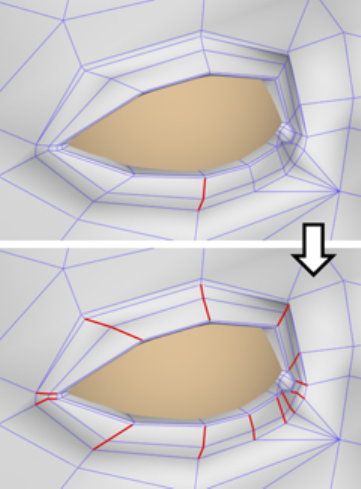
Ring selection adds to the selection all the edges that are parallel to the ones selected
originally.
Loop Expands the selection as far as possible, in alignment with selected
edges.
Loop applies only to edge and border selections, and propagates only through
four-way junctions.
Poly Select Modifier | 1547
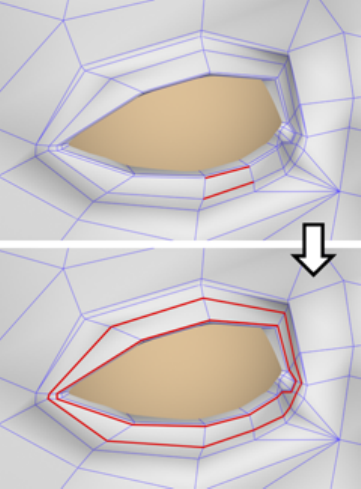
Loop selection extends your current edge selection by adding all the edges aligned to
the ones selected originally.
Get from Other Levels group
Applies selections from one sub-object level to another.
Get Vertex Selection Selects faces based on the last vertex selection. Selects
all faces shared by any selected vertex. The selection is added to the current
selection. Available only when the current sub-object level is not Vertex.
Get Poly Selection Selects vertices based on the last polygon/element
selection. This selection is added to the current selection. Available only when
the current sub-object level is not Polygon or Element.
Get Edge Selection Selects faces based on the last edge selection. Selects
those faces that contain the edge. Available only when the current sub-object
level is not Edge or Border.
Select by Material ID group
Selects faces based on their material ID.
1548 | Chapter 9 Modifiers
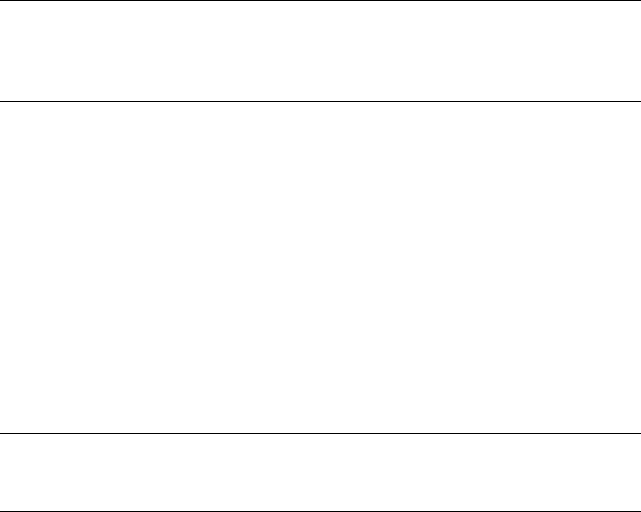
ID Set the spinner to the ID number you want to select, and then click the
Select button. Press Ctrl while clicking to add to the current selection, or press
Alt to remove from the current selection.
Named Selection Sets group
These functions are primarily for copying named selection sets on page 179
of sub-objects between similar objects, and between comparable modifiers
and editable objects. For example, you can apply a Poly Select modifier to a
sphere, create a named selection set of edges, and then copy the selection to
a different sphere that's been converted to an editable mesh object. You can
even copy the selection set to a different type of object, because the selection
is identified by the entities' ID numbers.
The standard procedure is to create a selection set, name it, and then use Copy
to duplicate it into the copy buffer. Next, select a different object and/or
modifier, go to the same sub-object level as you were in when you copied the
set, and click Paste.
NOTE Because sub-object ID numbers vary from object to object, the results of
copying named selection sets between different objects can be unexpected. For
example, if the buffered set contains only entities numbered higher than any that
exist in the target object, no entities will be selected when the set is pasted.
Copy Places a named selection into the copy buffer.
Paste Pastes a named selection from the copy buffer.
Select Open Edges Selects all edges with only one face. In most objects, this
will show you where missing faces exist. Available only at the Edge or Border
sub-object level.
Selection Info
At the bottom of the Parameters rollout for Mesh Select is a text display giving
you information about the current selection. If 0 or more than one sub-object
is selected, the text gives the number and type selected. If one sub-object is
selected, the text gives the ID number and type of the selected item.
NOTE When the current sub-object type is Element, selection information is given
in polygons When the current sub-object type is Border, selection information is
given in edges.
Poly Select Modifier | 1549
Soft Selection rollout
Soft Selection controls affect the action of sub-object Move, Rotate, and Scale
functions. When these are on, 3ds Max applies a spline curve deformation to
unselected vertices surrounding the transformed selected sub-object. This
provides a magnet-like effect with a sphere of influence around the
transformation.
For more information, see Soft Selection Rollout on page 1926 .
Preserve Modifier
Modify panel > Make a selection. > Modifier List > Object-Space Modifiers >
Preserve
Make a selection. > Modifiers menu > Parametric Deformers > Preserve
The Preserve modifier lets you retain, as much as possible, the edge lengths,
face angles, and volume of an edited and deformed mesh object using an
unmodified copy of the object before it was deformed. When you push and
pull vertices at the sub-object level, the process typically stretches the edges
and often alters the face angles, resulting in irregular topology. You can use
the Preserve modifier to generate more regular edge lengths, and a "cleaner"
mesh.
Procedures
Using the Preserve modifier:
1Create an object. Before you edit it, create a copy.
2Edit the copy at the sub-object level, pushing and pulling vertices, faces,
and so on.
3Apply the Preserve modifier to the copy, click the Pick Original button,
and then select the original, unmodified object.
4Adjust controls in the Preserve modifier to fine-tune the mesh.
Example: Use the Preserve modifier on a geosphere:
1Create a GeoSphere on page 361 and use Shift+Move to make a copy of
it.
1550 | Chapter 9 Modifiers

TIP If you want to see the effect of Preserve on mapping, apply a
checker-mapped material to the sphere and display it in the viewports before
making the copy.
2Convert the copy to an editable mesh on page 1990 .
3At the Vertex sub-object level, select a third of the vertices at the top of
the sphere, and move them upward (as seen from the front) about one
radius in distance.
Notice the stretched edges between the moved vertices and the remaining
vertices.
4While still at the Vertex sub-object level, apply the Preserve modifier.
5Click the Pick Original button, and then select the original (unedited)
sphere.
The selected vertices move back toward the sphere in an attempt to
maintain the original volume and edge lengths.
6Turn on Invert Selection.
The selected vertices return to their moved position, and the unselected
vertices (the inverted selection) move up toward the selected vertices.
7Turn off Invert Selection and slowly reduce the Iterations to 0.
The object now looks as it did before you applied Preserve.
8Increase Iterations to the default 25, and then increase it to approximately
75.
The object is now almost completely spherical again.
9Set Iterations back to 25, and then try different Edge Lengths, Face Angles,
and Volume settings. (You can restore the defaults by settings Edge
Lengths to 1.0, and Face Angles and Volume to 0.3.
Preserve Modifier | 1551
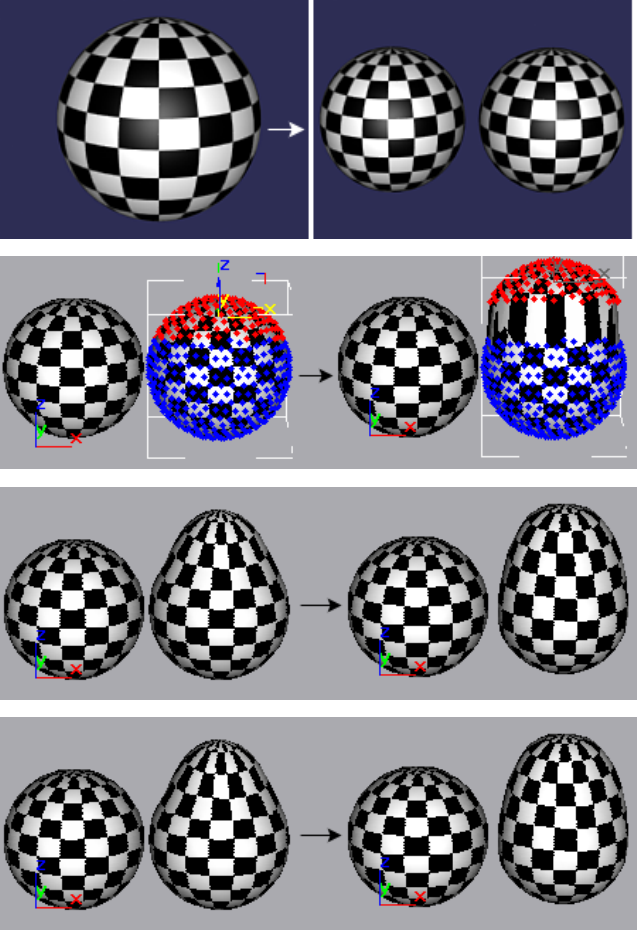
Steps in applying the Preserve modifier to a geosphere
1552 | Chapter 9 Modifiers

Example: Animating a preserved object:
You can animate the Preserve parameters, but the following procedure shows
you how to use Morph and Preserve together.
1Remove the Preserve modifier from the copied sphere, and go to object
level (instead of sub-object level).
2With the copied (and deformed) sphere still selected, choose Create
panel > Compound Objects > Morph to make it into a Morph object.
3Make sure Instance is chosen in the Pick Targets rollout.
4At frame 0, click Pick Target, and then select the original sphere.
5In the Modify panel, go to frame 100, select sphere02 in the Morph
Targets list, and click Create Morph Key.
The object now morphs from a sphere to a deformed sphere.
6Apply Preserve to the morph object.
7Click Pick Original, and select the original sphere.
The object now morphs from the sphere to a preserved and deformed
sphere. Note that because the object selection is passed up the stack, the
Preserve effect is applied to the entire sphere.
8Choose Selected Verts Only in the Selection group.
Now, only the selected vertices are affected by Preserve. The morph still
works, however.
Example: Using the Selection check boxes:
1Reset the program, create a box, and convert it to an editable mesh.
2Use Shift+Move to make a copy.
3 Use the Modify panel to select the top four vertices in the second
box. Move them upward in Z, making the copied box taller than the
original.
4Apply Preserve, and pick the first box as the original.
The selected vertices move down to match the original edge lengths.
Preserve Modifier | 1553
5Set Iterations to 0 to move the vertices back up, then turn on Invert
Selection, and set iterations back up to 25.
The selected vertices stay in their original locations, but the unselected
vertices move upward to restore the original edge lengths.
6Turn Iterations back down to 0. Turn on Apply To Whole Mesh (Invert
Selection becomes unavailable), and then turn Iterations back up to 25.
Preserve is now applied to the whole mesh. Since all vertices are affected,
the top and bottom of the box approach each other.
7Turn off Apply To Whole Mesh.
All vertices are translated, but maintain the same positions relative to
each other.
8Turn off Invert Selection and turn on Selected Verts Only.
You're back to the original effect. You can move the Iterations spinner
up and down to see that you're affecting only the selected vertices.
Example: Simulating cloth:
1Reset the program, create a Quad Patch Grid, and convert it to an editable
mesh.
2Make a copy, and then make a reference of the copy.
You should have a total of three objects in the scene.
3Apply Preserve to the third patch, using the first as the original.
4Select Selected Verts Only and Invert Selection.
5Set Iterations to 100.
6Select the second patch and go to the Sub-Object > Vertex level.
7Select a single vertex in the middle of the patch and move it upward in
Z.
The third patch becomes a floating handkerchief.
8Undo the vertex move.
9Select the far two corner vertices of the second patch, and drag them
upward in Z.
Now, you've got the beginnings of a sheet hanging on the line.
1554 | Chapter 9 Modifiers
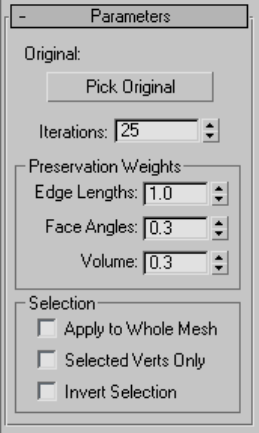
Interface
Original Displays the name of the selected original object. (Note that the
so-called "original" object doesn't actually have to be the original. It's simply
a copy of the object that represents its unmodified topology.)
Pick Original Click this, and then select an unmodified copy of the current
object. You should pick an object with the same topology as the current object,
which has the same number of vertices. While you can select a completely
different object with equal vertices, the results are unpredictable.
Iterations Specifies the number of calculations toward the solution. The
higher this number, the closer the object comes to matching the original
object and the slower the process. When this is set to zero, the original object
has no effect, as if the Preserve modifier were never applied.
Preservation Weights group
Edge Lengths, Face Angles, Volumes Adjusts the relative importance of the
three components you're attempting to preserve: edge lengths, face angles,
and volume. In most cases, you'd leave these at their default settings, but you
can achieve some interesting effects by altering them. Higher face angles, for
example, produce stiffer meshes.
Preserve Modifier | 1555
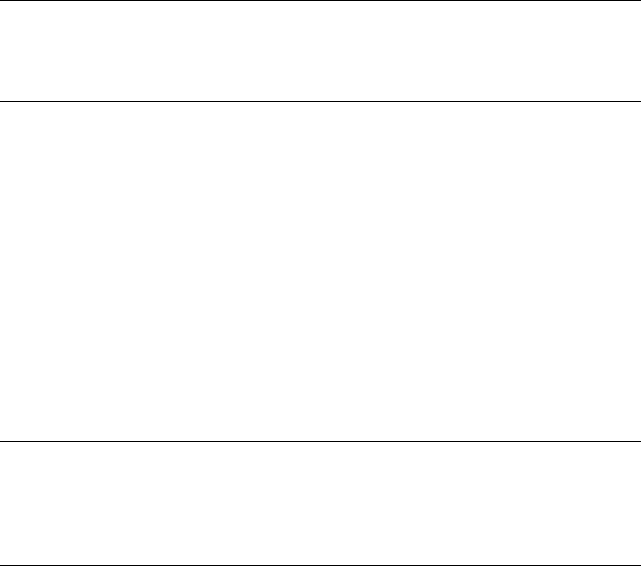
Selection group
Provides options that let you specify which selection level to take from previous
selection modifiers in the stack. The Preserve modifier acts on the specified
selection.
Apply to Whole Mesh Applies Preserve to the entire object, regardless of the
selection passed from previous levels of the stack. Disables the other two check
boxes.
Selected Verts Only Uses previous sub-object vertex selections. Note that it
doesn't matter if the Vertex sub-object level is active in a previous stack item.
As long as vertices have been selected, Preserve will use that selection.
Invert Selection Inverts the selection passed up the stack.
NOTE If all of the check boxes are turned off, Preserve uses whatever active
selection is passed up the stack. Thus, if a Mesh Select modifier is set to the Vertex
level, then that vertex selection is used. If the same Mesh Select modifier is set to
the top (object) level, then the entire object is affected.
Projection Modifier
Select an object. > Modify panel > Modifier List > Object-Space Modifiers >
Projection
The Projection modifier is used primarily to manage objects for producing
normal bump maps on page 6182 . You apply it to the low-resolution object,
and then pick a high-resolution object as the source for the projected normals.
When you use the Render To Texture dialog on page 6195 to set up projection,
Render To Texture applies the Projection modifier to the low-resolution object
automatically. You can also explicitly apply the Projection modifier to set up
the projection before you use Render To Texture.
NOTE The low-resolution object requires UV coordinates, but the high-resolution
source object does not need to have them. When the normals map is rendered,
you can choose to have Render To Texture apply an “Automatic Flatten UVs”
(Unwrap UVW) modifier on page 1769 to the top of the low-res object's stack; or
you can use existing mapping, if such exists.
You can apply more than one instance of the Projection modifier to the same
object, and you can instance it across multiple objects.
1556 | Chapter 9 Modifiers
The Projection modifier is a topology-dependent modifier on page 7951 , so
when you select an item in the stack that is lower than the Projection modifier,
you see a warning dialog that asks if you want to proceed. (The same is true
of the Automatic Flatten UVs modifier.)
Projection and Sub-Object Selections
You can match geometry to sub-object selections. There are two ways to do
so: matching material IDs, or matching named selections of sub-object
geometry.
Matching Material IDs
Here is a sample workflow for using material IDs to match portions of the
low-res object to different high-res objects:
1At the level of the low-res object itself, assign differing material IDs to
different face selections.
To do so, the low-res object must be a surface model; that is, an editable
mesh, editable poly, editable patch, or NURBS surface. Use the Surface
Properties rollout to change the material ID of sub-object selections.
2For the high-res target objects, assign corresponding material IDs.
An easy way to do this is to apply the Material modifier on page 1445 .
3In the Resolve Hit group of the Projection Options dialog on page 6214 ,
turn on Hit Only Matching Material ID.
4Render to texture.
The texture for faces of the low-res object receive texture element
information only from the source object that had the corresponding
material ID.
Matching Selected Geometry
Here is a sample workflow for using sub-object selections to match portions
of the low-res object to different high-res objects.
1In the Projection modifier, go to the Face or Element sub-object level.
See Selection Rollout (Projection Modifier) on page 1558 .
2Make a sub-object selection, then on the Reference Geometry rollout on
page 1560 , enter a descriptive name in the Name field.
Projection Modifier | 1557

3 Click the Add button or press Enter.
The name of the sub-object selection set is added to the list.
4Click in the list to highlight the selection-set name, click Pick or Pick
List, and then select the high-res source object to associate with the
sub-object selection.
5Repeat steps 2 through 4 to associate different sub-object selections with
different source objects.
6Choose Rendering > Render To Texture.
The Render To Texture dialog appears.
7In the Projection group of the Objects To Bake rollout on page 6199 , turn
off Object Level and turn on Sub-Object Levels.
8Click Render.
Render To Texture renders a separate texture for each of the named
sub-object selections contained in the Projection modifier.
Interface
The interface to the Projection modifier includes these rollouts:
Selection Rollout (Projection Modifier) on page 1558
Soft Selection Rollout on page 1926
Reference Geometry Rollout (Projection Modifier) on page 1560
Cage Rollout (Projection Modifier) on page 1563
Selection Check Rollout (Projection Modifier) on page 1567
Projection Rollout (Projection Modifier) on page 1568
Selection Rollout (Projection Modifier)
Select an object. > Modify panel > Modifier List > Object-Space Modifiers >
Projection > Selection rollout
The Projection modifier's Selection rollout is for managing sub-object
selections.
1558 | Chapter 9 Modifiers
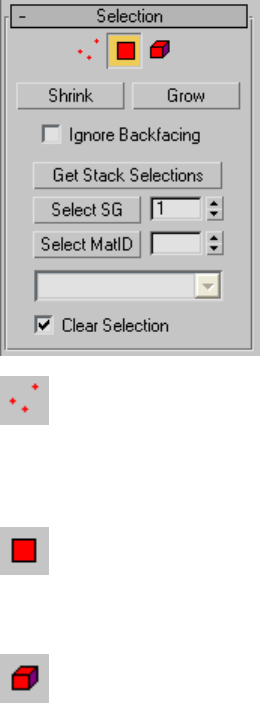
Interface
Cage Click to turn on the Cage sub-object level.
The Cage is the surface from which normals are projected. At the Cage
sub-object level, you can adjust the cage manually by transforming sub-object
selections of cage vertices.
Face Click to turn on the Face sub-object level.
The Face sub-object level lets you assign different source geometry to different
portions of a surface.
Element Click to turn on the Element sub-object level.
The element sub-object level lets you assign different source geometry to
individual elements. (An element is a group of contiguous faces.)
Shrink Reduces the sub-object selection area by deselecting the outermost
sub-objects. If the selection size can no longer be reduced, the remaining
sub-objects are deselected.
Grow Expands the selection area outward in all available directions.
Projection Modifier | 1559
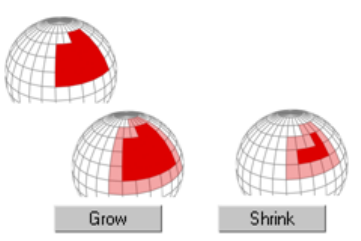
With Shrink and Grow, you can add or remove neighboring elements from the edges
of your current selection. Shrink and Grow work at any sub-object level.
Ignore Backfacing When on, selection of sub-objects affects only those facing
you. When off, you can select any sub-objects under the mouse cursor,
regardless of visibility or facing. If multiple sub-objects lie under the cursor,
repeated clicking cycles through them. Likewise, with Ignore Backfacing off,
region selection includes all sub-objects, regardless of the direction they face.
Default=off.
Get Stack Selections Click to collect sub-object selections from modifiers
that are below the Projection modifier on the stack.
Select SG To select by smoothing group value, use the spinner to set the
number of the smoothing group, and then click Select SG.
Select MatID To select by material ID, use the spinner to set the ID number,
and then click Select MatID.
■Sub-material drop-down list When a multi/sub-object material is applied
to the low-res object, this list shows the names and numbers of
sub-materials that are assigned to faces or elements of the object. When
you have selected by material ID, the corresponding sub-material appears
in the field above the list.
Clear Selection When on, each stack, smoothing group, or material ID
selection you make replaces the previous selection. When off, each new
selection is added to the previous selection set. Default=on.
Reference Geometry Rollout (Projection Modifier)
Select an object. > Modify panel > Modifier List > Object-Space Modifiers >
Projection > Reference Geometry rollout
1560 | Chapter 9 Modifiers

On the Reference geometry rollout, you can create named sub-object selection
sets, and associate them with high-resolution geometry.
Interface
Name Lets you enter a name for the current set of selected sub-objects.
Delete Click to delete the sub-object selection set whose name is
highlighted in the list.
Add Click to add the named sub-object selection set to the list.
Keyboard shortcut: Enter.
Select Click to select the sub-objects in the selection set whose name
is highlighted in the list.
Projection Modifier | 1561
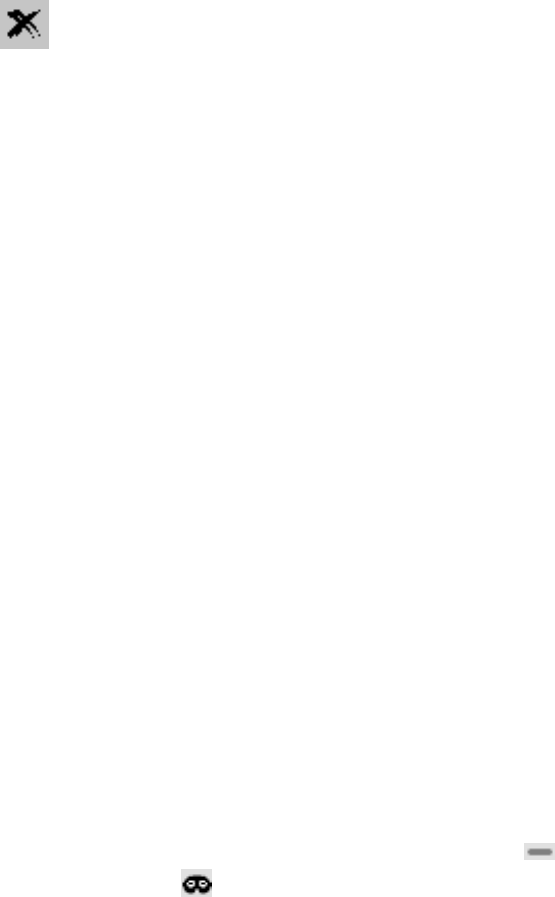
Delete All Click to delete all named sub-object selection sets in the
list.
Reference geometry window This window shows a list of named sub-object
selection sets, and the high-resolution source geometry with which they're
associated. If you have picked a high-res object at the object level, it also shows
“Object Level” followed by the name of the source object.
Proportion Multiplier When Proportional is chosen for sub-object normal
bump mapping in the Projection Mapping group of the Objects To Bake
rollout on page 6199 for Render To Texture, this value multiplies the default
size of the normal bump map. Range=0.0 to 2.0. Default=1.0.
For example, if Proportional rendering of a sub-object were to render a
sub-object selection at 16 x 16 pixels, changing Proportion Multiplier to 2.0
would change the size of the normal bump map to 32 x 32 pixels.
This control is unavailable unless a sub-object selection is active.
Pick To associate high-res geometry with the current selection, click Pick to
turn it on, then click a source object in a viewport.
Pick List To associate high-res geometry with the current selection, click Pick
List, then use the Add Objects dialog, which works like the Select From Scene
dialog on page 168 , to choose a source object.
Display Toggle group
The Display Toggle group is useful when you want to compare the hi—res to
your low-res geometry. You can quickly toggle between your low-res geometry
and your hi-res geometry to compare versions. You can show selected or all
hi-res geometry.
Enable When on, makes it possible to show or hide reference geometries.
Default=off.
Hide Reference Geometry/Hide Working Geometry When Enabled is on,
click Hide Reference Geometry to hide your hi-res geometry. Conversely, click
Hide Working Geometry to hide your low-res geometry. You can also selectively
show and hide high-res geometries in your Pick List. Click Off to hide a
geometry. Click Hide to show a geometry.
1562 | Chapter 9 Modifiers

Cage Rollout (Projection Modifier)
Select an object. > Modify panel > Modifier List > Object-Space Modifiers >
Projection > Cage rollout
These settings adjust the cage and its display. The cage is the nonrenderable
geometry that the Projection modifier uses as the surface from which it
ray-traces normals.
NOTE Special export/import functionality available on this rollout lets you convert
the cage into standard geometry of the same type and topology as the cage and
modified object, which you can edit using standard methods and then use to
define a new shape for the cage. This provides access to the full range of
mesh-editing tools available in 3ds Max for shaping the cage to your precise
requirements. For example, with editable poly, you can take advantage of tools
such as Loop, Ring, Grow, and Shrink, and quickly switch among sub-object levels
such as Face and Vertex.
Procedures
To use Export and Import with a cage:
1Create a cage:
1Create low-resolution and high-resolution objects. In most cases, for
best results they should be arranged concentrically.
2Apply the Projection modifier to the low-resolution object.
This creates the cage with the same shape and position as the
low-resolution object.
3Use the Reference Geometry rollout controls to specify one or more
high-resolution objects.
4On the Cage rollout, click Update.
This reshapes the cage, roughly enveloping the high-resolution
object(s).
2On the Cage rollout, click Export.
This creates a separate geometrical object in the same shape as the cage,
with the same type and topology as the low-resolution object. We'll call
this the cage object.
Projection Modifier | 1563

For example, if the low-resolution object is an editable poly, or has an
Edit Poly modifier at the top of the modifier stack, the resultant cage
object is of editable poly type.
3Use standard object-editing tools to modify the cage object's shape. Do
not alter its topology by adding or removing vertices, edges, etc., because
that would invalidate its usage for reshaping the cage. Also, for best results,
do not move the cage object. If you wish, you can temporarily hide any
overlapping objects.
4Select the low-resolution object.
5On the Cage rollout, click Import and then select the cage object.
If the cage object type and topology are the same as the low-resolution
object, the software reshapes the cage to match the cage object's shape.
Alternatively, if the cage object can be converted to the same type as the
low-resolution object without a change in topology, it is also accepted.
If not, a warning appears and no reshaping takes place.
IMPORTANT The resultant cage matches the imported cage object's shape,
position, orientation, and size exactly.
If the import is successful, the cage object can be deleted, or retained for
possible future cage modification.
1564 | Chapter 9 Modifiers
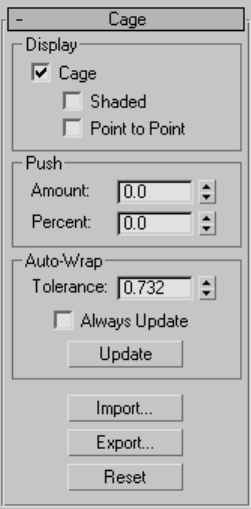
Interface
Display group
Cage When on, the cage is displayed. When off, the cage is hidden except
at the Cage sub-object level. Default=on.
The cage is always displayed at the Cage sub-object level, regardless of this
toggle's setting. See Selection Rollout (Projection Modifier) on page 1558 .
■Shaded When on, the cage is shaded with a transparent gray. When off,
the cage is displayed as a blue lattice. Default=off.
The Shaded option can be useful when you need to tell whether or not
high-resolution source geometry is within the cage, and when you need
to expand the cage to include more geometry.
■Point to Point When on, additional lines connect vertices in the cage to
points on the target object, showing how the projection will be done.
Default=off.
Projection Modifier | 1565

Push group
These controls let you adjust the size of the cage as a whole, or on a sub-object
selection if one is currently chosen (see Reference Geometry Rollout (Projection
Modifier) on page 1560 ).
Amount Change to adjust the size of the cage in 3ds Max units. Positive
values increase the size of the cage; negative values decrease the size.
Default=0.0.
Percent Change to adjust the size of the cage as a percentage. Positive values
increase the size of the cage; negative values decrease the size. Default=0.0.
Auto-Wrap group
By default, the Projection modifier does not automatically create a cage that
wraps around the geometry. To change the cage, use the settings in this group
or the Push group, or adjust cage vertices manually at the Cage sub-object
level.
Tolerance The distance in 3ds Max units, between the cage and the target
geometry. Positive values are outside the high-res source geometry; negative
values are inside the source geometry. Default=varies, depending on the
geometry.
Always Update When on, the cage automatically expands around high-res
geometry as it is added to the list (see Reference Geometry Rollout (Projection
Modifier) on page 1560 ). When off, the initial cage is not updated automatically.
Default=off.
Update Click to update the cage. Use this when Always Update is off.
Import Lets you specify a mesh object to define the cage shape. This is
typically an object that was created with Export (see following) and then
modified using standard mesh-editing methods. After clicking Import, select
the object to import. After importing the object, the cage conforms to its
shape. You can then delete the imported object if you wish.
IMPORTANT The imported object should be of the same type (for example,
editable mesh) as the projection object (that is, the object with the Projection
modifier), or be convertible to that type without topology change, and must have
the identical topology. If it doesn't meet either or both of those criteria, an alert
appears requesting that you select an object of the same type and identical
topology.
1566 | Chapter 9 Modifiers
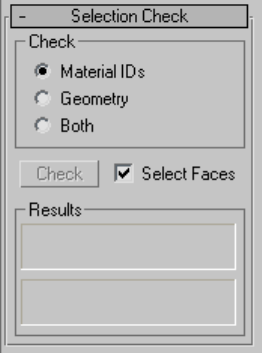
Export Creates a geometry object from the cage, with the same type and
topology as the modified object. Clicking Export causes the Export Cage dialog
to open. Accept the default “Export as” object name or enter a new one, and
then click OK.
For a detailed description of the export/import process, see To use Export and
Import with a cage: on page 1563 .
Reset Click to reset the cage to a wrapping that is the same size as the
low-resolution target geometry.
Selection Check Rollout (Projection Modifier)
Select an object. > Modify panel > Modifier List > Object-Space Modifiers >
Projection > Selection Check rollout
This rollout lets you check selections to see if any are overlapping; that is, if
a material ID or a face or element is assigned to more than one selection.
Interface
Check group
■Material IDs Checks for material IDs being assigned to more than one
selection.
Projection Modifier | 1567
■Geometry Checks for faces or elements being assigned to more than one
selection.
■Both (The default.) Checks for both material ID and sub-object overlap.
Check Click to run the check.
Select Faces When on, if running the selection check detects “bad” selections,
the “bad” faces are selected by the Projection modifier automatically. When
off, “bad” selections are not selected automatically. Default=on.
Results group
After you click Check, the fields in this group display the results. The first field
is for material IDs, and the second is for sub-object selections. If there is no
conflict, the first field says “No conflicting Mat IDs detected,” and the second
says “No conflicting face selections detected.” If there is a conflict, the results
say something such as, “6 Mat IDs are assigned to more than one selection.”
Projection Rollout (Projection Modifier)
Select an object. > Modify panel > Modifier List > Object-Space Modifiers >
Projection > Projection rollout
The Projection rollout has controls for projecting data from the object with
the Projection modifier to a different object. This data flow is the reverse of
what it is when you project normals from a high-resolution object to a
low-resolution object.
1568 | Chapter 9 Modifiers
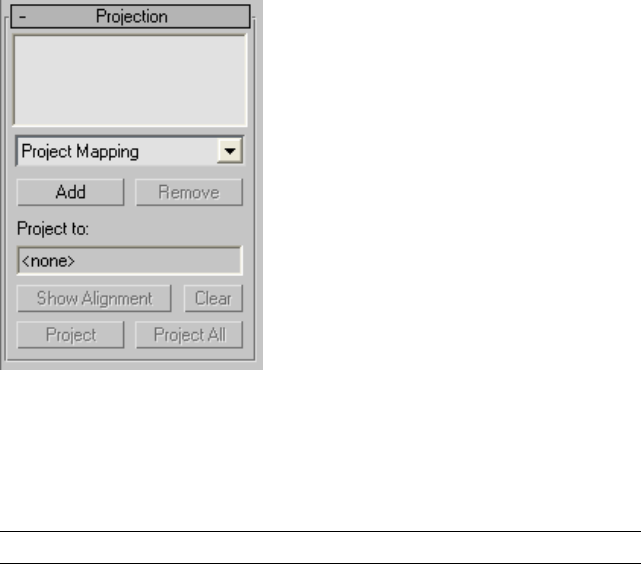
Interface
Projector list Shows the active projector plug-ins.
Projector plug-in drop-down list Lets you choose a projector plug-in. Only
one projector, Project Mapping, is provided with 3ds Max. See Project Mapping
Rollout (Projection Modifier) on page 1570 . Additional projectors might be
available from third-party sources.
NOTE Multiple instances of the Project Mapping plug-in can be active.
Add Adds a projector of the type chosen in the drop-down list.
Remove Removes the projector that is currently highlighted in the projector
list.
Project to Shows the name of the geometry to which you're projecting. To
choose this geometry, use the Reference Geometry rollout on page 1560 .
Show Alignment Click to display the faces of the geometry selection that
will project to the selected faces of the object that has the Projection modifier.
This shows which hi-res faces will be projected to the selected low-res faces.
This works only for selected faces, not selected vertices: you can lock a face
selection and then make adjustments to the cage, then click Show Alignment
to see the effects of the cage modification.
This button is unavailable if no selection has been made in the Reference
Geometry rollout.
Projection Modifier | 1569
Clear Click to turn off the Show Alignment display.
Project Click to perform the projection.
Project All Click to perform all projections that are in the projector list.
Project Mapping Rollout (Projection Modifier)
Select an object. > Modify panel > Modifier List > Object-Space Modifiers >
Projection > Projection rollout > Choose Project Mapping in the plug-in
drop-down list (this is the only available choice unless third-party plug-ins
have been installed). > Click Add > Project Mapping rollout.
Select an object. > Modify panel > Modifier List > Object-Space Modifiers >
Projection > Projection rollout > Highlight a Project Mapping projector in the
Projector list. > Project Mapping rollout.
The Project Mapping rollout contains controls for the Project Mapping
projector plug-in. This rollout is visible when a Project Mapping instance is
highlighted in the Projector list on the Projection rollout on page 1568 . Use
Project Mapping to project a map channel value, material IDs, or vertex
attributes from the object that has the Projection modifier applied, onto other
geometry.
1570 | Chapter 9 Modifiers

Interface
Projection Modifier | 1571

Projector name field Shows the name of the Project Mapping projector. If
you edit this field, the change is reflected on the Projection rollout on page
1568 .
Projection Holder group
Projection Holder name field Shows the name of the Projection Holder
modifier. If you edit this field, the change is reflected in the target object's
stack, but not until you click Project on the Projection rollout.
Create New Holder When you click the Project button in the Project rollout,
a Projection Holder modifier is added to the geometry selection. When Create
New Holder is on, 3ds Max creates and adds a new modifier each time you
click Project. When Create New Holder is off, clicking Project simply updates
the data in the existing Projection Holder; it creates a new Projection Holder
modifier only if none was present, before. Default=off.
Same Topology When on, the source object's topology is transferred to the
target object. Default=off.
IMPORTANT You need to turn on Same Topology when you project to the target
object's Vertex Position.
Always Update When on, changing the object with the Projection modifier
automatically re-projects and updates the Projection Holder modifiers on the
geometry selections. When off, projection is recalculated only when you click
Project. Default=off.
This toggle is available only when Create New Holder is off and Same Topology
is on.
When Always Update is on, changes to the geometry with the Projection
modifier can manipulate UVW channels or animate vertex colors of the objects
with the Projection Holder modifiers.
Source Channel group
■Map Channel (The default.) Projects a map channel on page 7836 value.
Use the spinner to set the channel value.
■Vertex Color Projects vertex color values.
■Vertex Illum Projects vertex illumination (grayscale) values.
■Vertex Alpha Projects vertex alpha values.
■Vertex Position Projects vertex positions.
1572 | Chapter 9 Modifiers

Target Channel group
Same as Source When on, the radio buttons in this group are disabled, and
the Project Mapping projector projects to the same channel that is chosen in
the Source Channel group. When off, the radio buttons in this group are
enabled. Default=on.
The radio buttons are the same as the ones in the Source Channel group.
When Same As Source is off, the chosen map channel or vertex data of the
target geometry derives its value from the channel or vertex data chosen in
the Source Channel group.
The projection does not take place until you click Project or Project All on the
Projection rollout.
Project Material IDs When on, projects values. Default=off.
The projection does not take place until you click Project or Project All on the
Projection rollout.
Projection Mapping Quality group
Use these settings to improve the quality of the mapping when projecting
texture mapping from one object to another.
Ignore Backfaces When on, does not take backfaces into account when
calculating the projection. In the case of overlapping faces, this can prevent
projection, resulting in undesirable erroneous faces. In almost all cases this
should remain off.
Test Seams Tests for seams by walking around the neighboring faces and
then will try to fix the faces
Check Edge Ratios Attempts to correct UVW faces that look abnormal; that
is, that are not similar to their geometry faces. This compares edge ratio lengths
and angle ratio. It typically finds the sliver faces generated by projections
across seams. The larger the Threshold value, the more likely a face is to be
tagged as abnormal and fixed.
Weld UVs Welds all the UVs at the end of the projection and combines them
into groups, based on the Threshold value. The Threshold value is based on
edges, so it welds UVs based on the the closest N edges. In most cases this
should be on.
Projection Modifier | 1573
Projection Holder Modifier
Select an object. > Modify panel > Modifier List > Object-Space Modifiers >
Projection modifier > Geometry rollout > Choose target geometry > Projection
rollout > Click Add. > Click Project. > Projection Holder is applied to the target
geometry.
The Projection Holder modifier appears for objects being used by the Projection
modifier's Project Mapping feature on page 1568 . It contains the data generated
by the Project Mapping operation, much as UVW Mapping Add or UVW
Mapping Clear do for Channel Info manipulations.
Interface
The Projection Holder modifier has no parameters.
Push Modifier
Modify panel > Make a selection. > Modifier List > Object-Space Modifiers >
Push
Make a selection. > Modifiers menu > Parametric Deformers > Push
The Push modifier lets you "push" object vertices outward or inward along
the average vertex normals. This produces an "inflation" effect that you can't
otherwise obtain.
1574 | Chapter 9 Modifiers
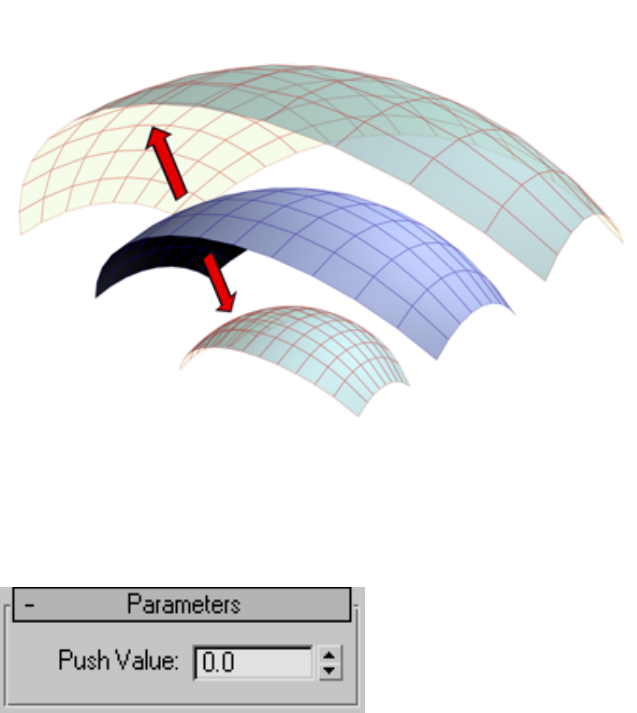
Positive and negative amounts of push applied to an object.
Interface
Push Value Sets the distance in world units by which vertices are moved
with respect to the object center. Use a positive value to move vertices outward,
or a negative value to move vertices inward.
Relax Modifier
Modify panel > Make a selection. > Modifier List > Object-Space Modifiers >
Relax
Make a selection. > Modifiers menu > Parametric Deformers > Relax
Relax Modifier | 1575
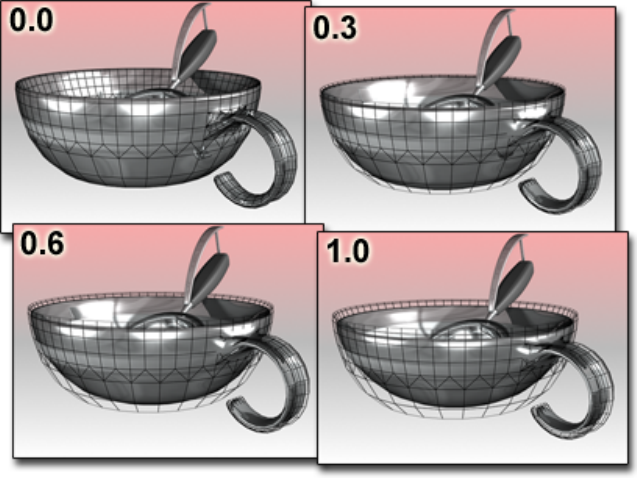
The Relax modifier changes the apparent surface tension in a mesh by moving
vertices closer to, or away from, their neighbors. The typical result is that the
object gets smoother and a little smaller as the vertices move toward an
averaged center point. You can see the most pronounced effects on objects
with sharp corners and edges.
Relax moves the bowl away from its original contours.
When you apply Relax, each vertex is moved toward the average position of
its neighboring vertices. A neighboring vertex is one that shares a visible edge
with the current vertex.
1576 | Chapter 9 Modifiers
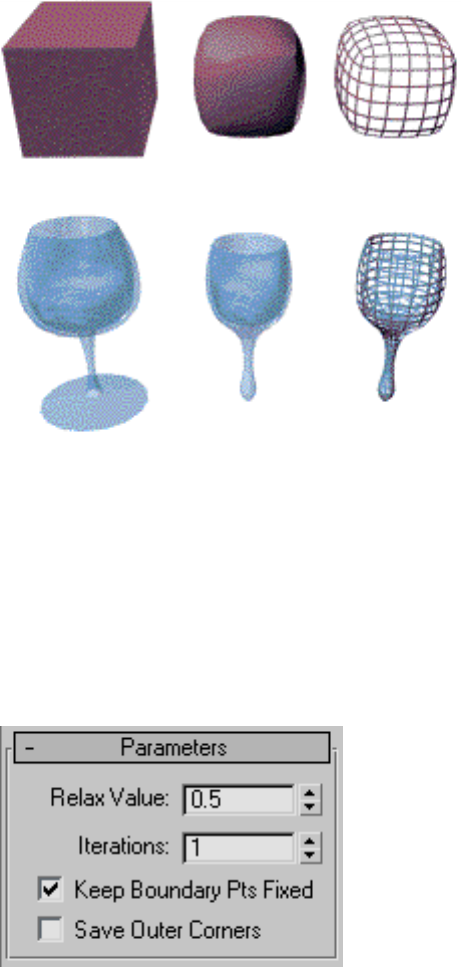
Original objects compared to relaxed objects
Patches
As of version 4, a patch object coming up the modifier stack is not converted
to a mesh by this modifier. A patch object input to the Relax modifier retains
its patch definition. If a file created by a previous version of 3ds Max contains
a patch object applied with the Relax modifier, it will be converted to a mesh
to maintain backward compatibility.
Interface
Relax Modifier | 1577
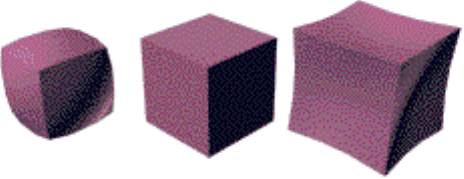
Relax Value Controls how far a vertex moves for each iteration. The value
specifies a percentage of the distance from the original location of a vertex to
the average location of its neighbors. Range=-1.0 to 1.0. Default=0.5.
■Positive Relax values move each vertex in closer to its neighbors. The object
becomes smoother and smaller.
■When the Relax value=0.0, vertices do not move and Relax has no affect
on the object.
■Negative Relax values move each vertex away from its neighbors. The
object becomes more irregular and larger.
Relax Values=1.0, 0.0, -1.0
Iterations=1 (default)
Iterations Sets how many times to repeat the Relax process. For each iteration,
average locations are recalculated and the Relax Value is reapplied to every
vertex. Default=1.
■For 0 iterations, no relaxation is applied.
■Increasing iterations for positive Relax Value settings smooths and shrinks
an object. With very large iteration values, the object shrinks to a point.
■Increasing iterations for negative Relax Value settings exaggerates and
expands an object. With relatively few iterations, the object becomes
jumbled and almost unusable.
1578 | Chapter 9 Modifiers
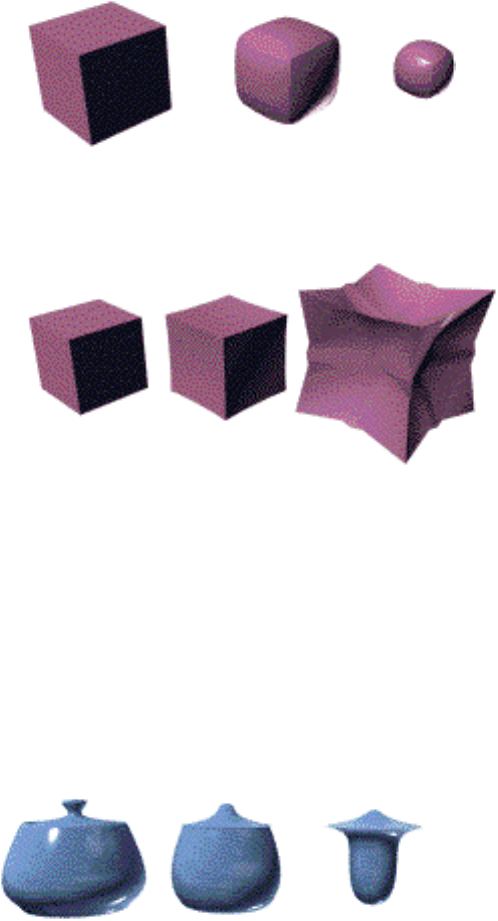
Iterations=0, 10, 50
Relax Value=0.5 (default)
Iterations=0,1, 5
Relax Value=-0.5
Keep Boundary Pts Fixed Controls whether vertices at the edges of open
meshes are moved. Default=on.
When Keep Boundary Pts Fixed is on, boundary vertices do not move while
the rest of the object is relaxed. This option is particularly useful when working
with multiple objects, or multiple elements within a single object, that share
open edges.
When this check box is off, all vertices of the object are relaxed.
Keep Boundary Pts Fixed=on
Iterations=0, 10, 50
Relax Modifier | 1579
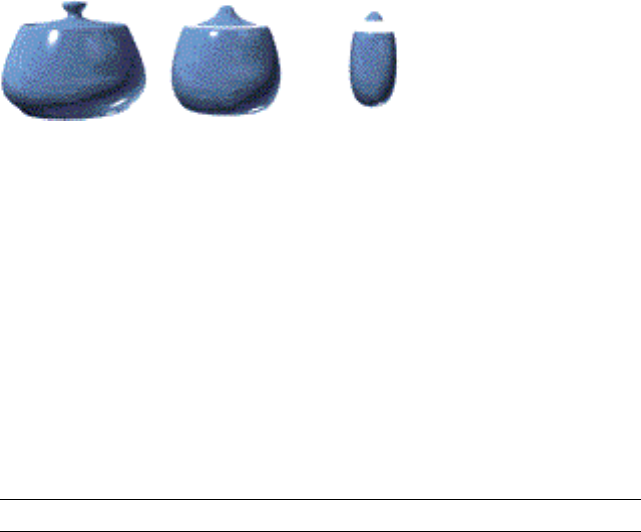
Keep Boundary Pts Fixed=off
Iterations=0, 10, 50
Save Outer Corners Preserves the original positions of vertices farthest away
from the object center.
Renderable Spline Modifier
Select a shape. > Modify panel > Modifier List > Renderable Spline
The Renderable Spline modifier lets you set the renderable properties of a
spline object, without collapsing the spline to an editable spline. This is
particularly useful with splines you have linked to from AutoCAD. It also lets
you apply the same rendering properties to multiple splines at once.
NOTE This modifier cannot be applied to NURBS curves.
1580 | Chapter 9 Modifiers
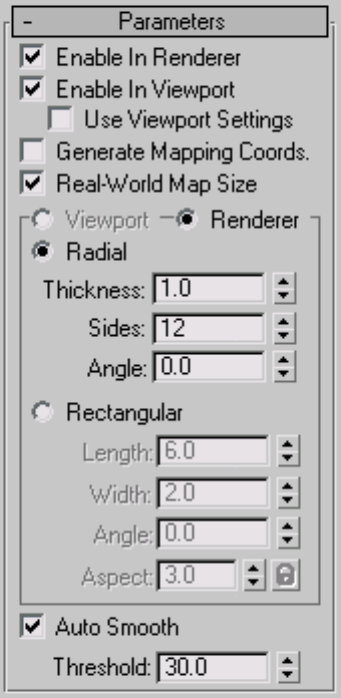
Interface
Enable In Renderer When on, the shape is rendered as a 3D mesh using the
Radial or Rectangular parameters set for Renderer. In previous versions of the
program, the Renderable switch performed the same operation.
Enable In Viewport When on, the shape is displayed in the viewport as a
3D mesh using the Radial or Rectangular parameters set for Renderer. In
previous versions of the program, the Display Render Mesh performed the
same operation.
Renderable Spline Modifier | 1581
Use Viewport Settings Lets you set different parameters for viewport display
and rendering, and displays the mesh generated by the Viewport settings in
the viewports. Available only when Enable in Viewport is turned on.
Generate Mapping Coords Turn this on to apply mapping coordinates.
Default=off.
3ds Max generates the mapping coordinates in the U and V dimensions. The
U coordinate wraps once around the spline; the V coordinate is mapped once
along its length. Tiling is achieved using the Tiling parameters in the applied
material. For more information, see Mapping Coordinates on page 5183 .
Real-World Map Size Controls the scaling method used for texture mapped
materials that are applied to the object. The scaling values are controlled by
the Use Real-World Scale settings found in the applied material's Coordinates
rollout on page 5620 . Default=on.
Viewport Choose this to specify Radial or Rectangular parameters for the
shape as it will display in the viewport when Enable In Viewport is on.
Available only when Use Viewport Settings is on
Renderer Choose this to specify Radial or Rectangular parameters for the
shape as it will display when rendered or displayed in the viewport when
Enable in Viewport is turned on.
Radial Displays the spline as a 3D object with a circular cross-section.
■Thickness Specifies the cross-section diameter. Default=1.0. Range=0.0
to 100,000,000.0.
■Sides Sets the number of sides for the spline mesh in the viewports or
renderer. For example, a value of 4 produces a square cross-section.
■Angle Adjust the rotational position of the cross section in the viewports
or renderer. For example, if you have a square cross section you can use
Angle to position a “flat” side down.
Rectangular Displays the spline as a 3D object with a rectangular
cross-section.
■Length Specifies the size of the cross–section along the local Y axis.
■Width Specifies the size of the cross–section along the local X axis.
■Angle Adjusts the rotational position of the cross-section in the viewport
or renderer. For example, if you have a square cross-section you can use
Angle to position a "flat" side down.
1582 | Chapter 9 Modifiers

■Aspect Sets the aspect ratio for rectangular cross-sections. The Lock check
box lets you lock the aspect ratio. When Lock is turned on, Width is locked
to Depth that results in a constant ratio of Width to Depth.
Auto Smooth When on, the spline is auto-smoothed using the smoothing
angle specified by the Threshold setting. Auto Smooth sets the smoothing
based on the angle between spline segments. Any two adjacent segments are
put in the same smoothing group if the angle between them is less than the
threshold angle.
NOTE Turning Auto Smooth on for every situation does not always give you the
best smoothing quality. Altering the Threshold angle may be necessary or turning
Auto Smooth off may produce the best results.
Threshold Specifies the threshold angle in degrees. Any two adjacent spline
segments are placed in the same smoothing group if the angle between them
is less than the threshold angle.
Ripple Modifier
Modify panel > Make a selection. > Modifier List > Object-Space Modifiers >
Ripple
Make a selection. > Modifiers menu > Parametric Deformers > Ripple
The Ripple modifier lets you produce a concentric rippling effect in an object's
geometry. You can set either of two ripples or a combination of both. Ripple
uses a standard gizmo and center, which you can transform to increase the
possible ripple effects.
The Ripple on page 2699 space warp has similar features. It is useful for applying
effects to a large number of objects.
Ripple Modifier | 1583
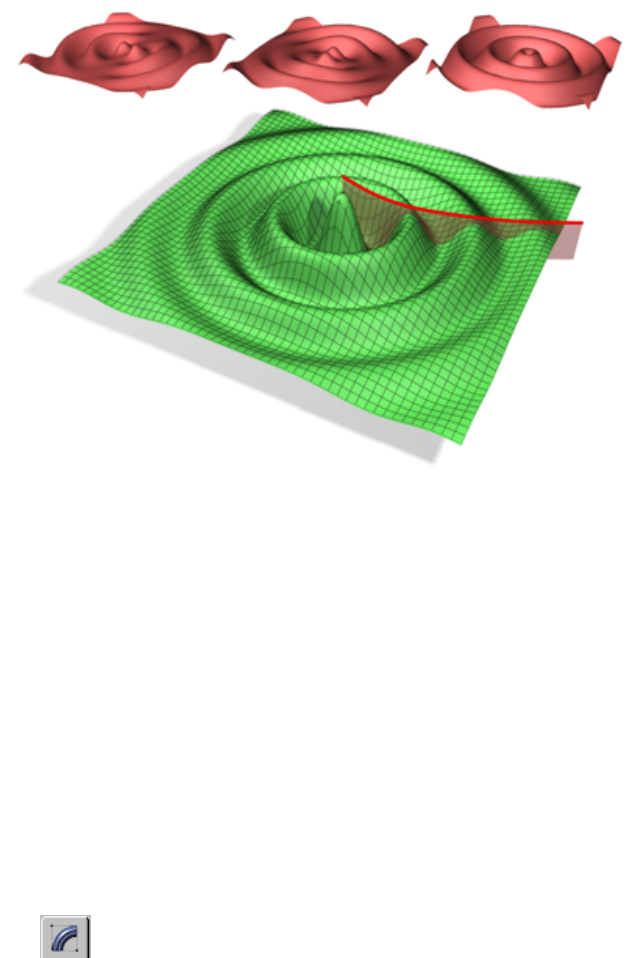
An object with the Ripple modifier applied.
Top (from left to right): Amplitude 1 only, Amplitude 2 only and both amplitudes.
Bottom: Both amplitudes with the Decay effect.
See also:
■Wave Modifier on page 1918
Procedures
Example: To use the Ripple modifier:
1Start with an empty scene, and add a Plane object on page 380 in the
Perspective viewport. Set Length and Width both to 100.0, and set Length
Segs and Width Segs both to 10.
The Plane object is useful as the basis for the surface of a body of water
in which ripples form.
2 Go to the Modify panel, click Modifier List, and, from the
Object-Space Modifiers list, choose Ripple.
1584 | Chapter 9 Modifiers
This applies the modifier to the Plane object.
3On the Parameters rollout, set Amplitude 1 to 10.0.
A large ripple forms in the Plane object.
You can change the horizontal scale by adjusting the wave length.
4Set Wave Length to 20.0. The waves become smaller, but now it's apparent
that the Plane object needs greater geometric resolution to properly
display the number of waves.
5In the modifier stack, click the Plane item, and then set Length Segs and
Width Segs both to 30.
The smaller waves become more apparent. The Ripple modifier needs a
relatively high number of subdivisions in the geometry it's applied to in
order to work properly.
You can use the Amplitude 2 parameter to add complexity to the wave
forms created by Ripple.
6Return to the Ripple level of the modifier stack, and then click and hold
on the Amplitude 2 and drag downward.
As you drag, a new set of wave forms are combined with the existing
ones. The farther you drag, the more dominant the second set becomes.
Using a negative value for Amplitude 2 (or a positive one if Amplitude 1
is negative) produces more of an interference effect between the two sets
of waves.
You can animate the waves with the Phase control.
7Drag slowly upward or downward on the Phase spinner.
Increasing the Phase value moves the waves inward, and decreasing it
moves the outward. To animate the waves, create keyframes on page 7344
for the Phase value.
To simulate an object dropping in liquid, use the Decay setting.
8Drag slowly upward on the Decay spinner.
The farther you drag, the more the wave sizes decrease with the distance
from the center of the effect. This is the effect you get when an object
perturbs the water surface, and the waves lose energy as they move away
from the point of impact.
Ripple Modifier | 1585
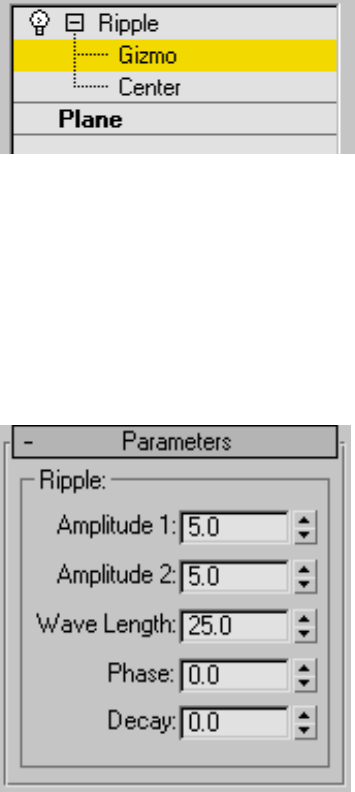
Interface
Modifier Stack
Gizmo At this sub-object level, you can transform and animate the gizmo
like any other object, altering the effect of the Ripple modifier. Translating
the gizmo translates its center an equal distance. Rotating and scaling the
gizmo takes place with respect to its center.
Center At this sub-object level, you can translate and animate the center of
the ripple effect, and thus the shape and positions of the ripples.
For more information on the stack display, see Modifier Stack on page 7427 .
Parameters rollout
Amplitude 1/ Amplitude 2 Amplitude 1 produces a ripple across the object
in one direction, while Amplitude 2 creates a similar ripple at right angles to
the first (that is, rotated 90 degrees about the vertical axis).
1586 | Chapter 9 Modifiers
Wave Length Specifies the distance between the peaks of the wave. The
greater the length, the smoother and more shallow the ripple for a given
amplitude. Default=50.0.
Phase Shifts the ripple pattern over the object. Positive numbers move the
pattern inward, while negative numbers move it outward. This effect becomes
especially clear when animated.
Decay Limits the effect of the wave generated from its center.
The default value of 0.0 means that the wave will generate infinitely from its
center. Increasing the Decay value causes the wave amplitudes to decrease
with distance from the center, thus limiting the distance over which the waves
are generated.
Select By Channel Modifier
Select an object. > Modify panel > Modifier List > Select By Channel
The Select By Channel modifier works in conjunction with the Channel Info
utility on page 5858 . After you store a vertex selection into a subcomponent
with Channel Info, use Select By Channel to quickly access the selection.
Procedures
To use Select By Channel:
1Use Channel Info to store one or more vertex selections in a map channel
subcomponent.
2Apply the Select By Channel modifier to the object with the stored vertex
selection(s).
3Choose the selection type.
4Choose the selection channel.
5To “bake” the new selection into the object, collapse the stack.
Select By Channel Modifier | 1587
Interface
Selection Type Lets you choose how to combine the stored vertex selection
with an existing vertex selection.
■Replace Replaces the existing selection with the stored selection.
■Add Adds the stored selection to the existing selection.
■Subtract Subtracts the stored selection from the existing selection. Has
no effect if there's no overlap between the stored selection and the existing
selection.
Selection Channel Lets you choose which stored, named vertex-selection
channel to apply to the modified object. Click the arrow to the right of the
name field to open the drop-down list, and then click a channel in the list.
Shell Modifier
Modify panel > Make a selection. > Modifier List > Object-Space Modifiers >
Shell
Make a selection. > Modifiers menu > Parametric Deformers > Shell
The Shell modifier “solidifies” or gives thickness to an object by adding an
extra set of faces facing the opposite direction of existing faces, plus edges
connecting the inner and outer surfaces wherever faces are missing in the
original object. You can specify offset distances for the inner and outer surfaces,
characteristics for edges, material IDs, and mapping types for the edges.
Also, because the Shell modifier doesn't have sub-objects, you can use the
Select options on page 1595 to specify a face selection for passing up the stack
to other modifiers. Please note that the Shell modifier doesn't recognize existing
sub-object selections, nor does it pass such selections up the stack.
1588 | Chapter 9 Modifiers
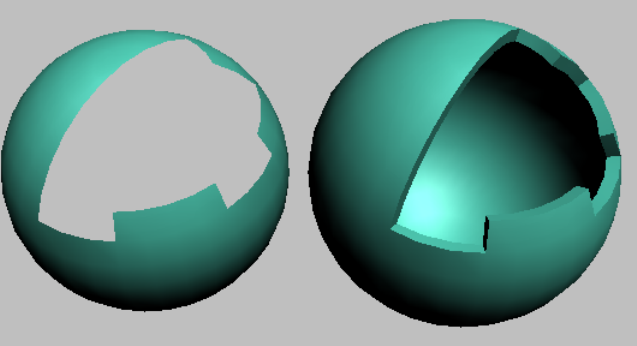
Left: Sphere with part of surface removed; Right: Sphere with Shell applied
You'd typically use Shell on an object with part of its surface removed, such
as a sphere with several deleted vertices or faces, as illustrated above. For best
results, the original polygons should face outward. If an object has no faces
with at least one free edge, Shell will not create any edges.
Examples of Shell Usage
Following are some examples of modeling tasks for which the Shell modifier
would be appropriate:
■An artist is modeling a vehicle such as a car, a tank, or, in this case, a
helicopter. The artist builds a solid external shell as the body of the copter.
When done, the modeler breaks up his model: he selects window areas
and detaches them as new objects, followed by the area for the doors (also
detached as new objects). The modeler now has open objects representing
the body, windows, and doors. The modeler applies Shell to the body, and
sets it to extrude both outward and inward a set number of units, setting
the inward extrusion to be greater than the outward. Shell is applied to
the windows next; these are set to extrude inward only. The modeler then
copies the Shell modifier from the body to the doors, and reduces the
doors' outward extrusion somewhat. The result is a solid body with an
interior that can accept additional modeling, inset windows, and doors
that are slightly less thick than the shell of the helicopter.
■A designer is modeling a manufactured object that will need to be shown
in an exploded view. It might be a cell phone, an engine, a mouse, shaped
Shell Modifier | 1589
glass, or something similar; this example will use part of a cell phone.
When working on the phone keypad area, if the modeler builds with detail
in mind, she might accurately model the shell with a moderately dense
mesh, using ShapeMerge on page 681 to create the shapes for the holes
where the keys will poke through, and then deleting those faces. When
satisfied, the modeler applies the Shell modifier, sets Segments to 2, and
then turns on the Bevel Edges option to use a curve for the profile of the
holes' edges. She then applies a MeshSmooth modifier on top. The extra
segment helps control the curve of the edges where the outer surface curves
down to the keypad holes. The modeler then goes back to the cage portion
of the stack and refines the base mesh details to her liking.
■A modeler is creating a suit of futuristic armor for a character. The modeler
copies a selection of polygons from the character mesh to a new object;
for example, the polygons that make up the arm. The modeler deletes
some faces from the copied arm, and perhaps cuts some holes from it. He
then applies the Shell modifier, followed by a MeshSmooth modifier,
resulting in form-fitting armor.
Procedures
To solidify an object:
1Create an object to solidify. The object should have some holes in its
surface. For example, start with a primitive sphere, convert it to Editable
Poly, and delete some vertices or polygons.
2Optionally create an open spline to serve as the profile for the edges
connecting the inner and outer surfaces. For example, go to Create panel
> Shapes and click Line. Then, in the Top viewport, draw the spline in
the Top viewport from top to bottom. Where the spline protrudes to the
right, the edge surface will be convex, and where it protrudes to the left,
the surface will be concave.
3Apply the Shell modifier to the object from step 1.
4To use custom edges, turn on Bevel Edges, click the Bevel Spline button,
and then select the spline from step 2.
5By default, Shell keeps the material IDs of the new surfaces consistent
with those of the original object. To change these, turn on the different
Override options, specify appropriate material IDs, and apply a
Multi/Sub-Object material on page 5558 .
1590 | Chapter 9 Modifiers
6Likewise, Shell keeps the texture coordinates of the new surfaces consistent
with those of the original object. To change these on the new edges,
change the Edge Mapping choice, and with the Strip and Interpolate
choices, optionally change the TV Offset setting.
Shell Modifier | 1591

Interface
Inner/Outer Amount Distance in 3ds Max generic units by which the inner
surface is moved inward and the outer surface is moved outward from their
original positions. Defaults=0.0 / 1.0.
1592 | Chapter 9 Modifiers
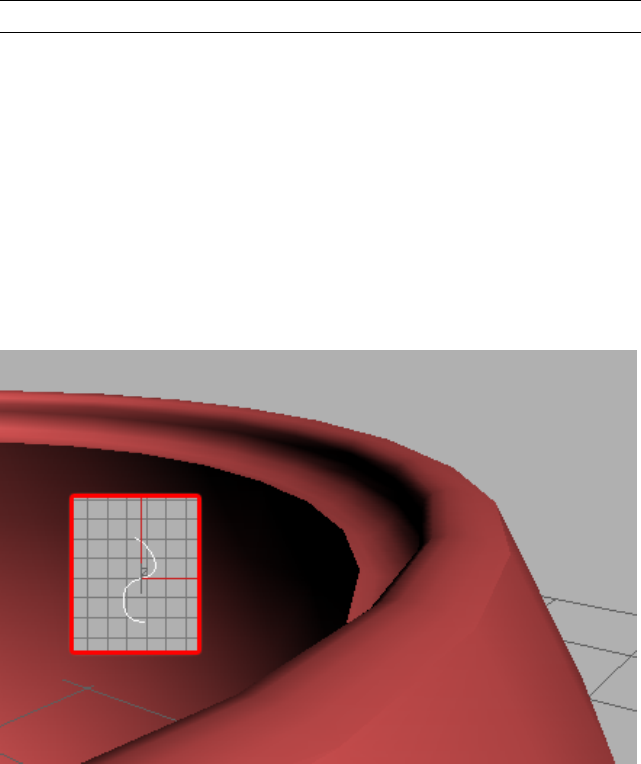
The sum of the two Amount settings determines the thickness of the object's
shell, as well as the default width of the edges. If you set both to 0, the resultant
shell has no thickness, and resembles an object set to display as 2-sided.
Segments The number of subdivisions across each edge. Default=1.
Change this setting if you need greater resolution on the edge for use by
subsequent modeling or modifiers.
NOTE When you use a Bevel Spline, the spline's properties override this setting.
Bevel Edges When on, and you specify a Bevel Spline, the software uses the
spline to define the edges' profile and resolution. Default=off.
After you define a Bevel Spline, use Bevel Edges to switch between a flat edge
whose resolution is defined by the Segments setting and a custom profile
defined by the Bevel Spline.
Bevel Spline Click this button and then select an open spline to define the
edge shape and resolution. Closed shapes such as Circle or Star will not work.
The original spline is instanced to the Bevel Spline, so changing the spline's
shape and properties are reflected in the Bevel Spline. With non-corner vertices,
you can change the edge resolution with the spline's Interpolation rollout
settings.
A bevel spline as viewed from the top (inset) and the resulting bevel
Shell Modifier | 1593

TIP For best results, create the spline in the Top viewport, and draw it from top
to bottom. The top point on the spline is applied to the outside edge, and the
bottom point to the inside edge. Displacements to the right will create outward
protrusions on the edge profile, and displacements to the left create inward
protrusions.
Override Inner Mat ID Turn on to specify a material ID for all of the inner
surface polygons using the Inner Mat ID parameter. Default=off.
If you don't specify a material ID, the surface uses the same material ID or IDs
as the original faces.
Inner Mat ID Specifies the material ID for inner faces. Available only when
Override Inner MatID is on.
Override Outer Mat ID Turn on to specify a material ID for all of the outer
surface polygons using the Outer Mat ID parameter. Default=off.
If you don't specify a material ID, the surface uses the same material ID or IDs
as the original faces.
Outer Mat ID Specifies the material ID for outer faces. Available only when
Override Outer MatID is on.
Override Edge Mat ID Turn on to specify a material ID for all of the new
edge polygons using the Edge Mat ID parameter. Default=off.
If you don't specify a material ID, the surface uses the same material ID or IDs
as the original faces from which the edges are derived.
Edge Mat ID Specifies the material ID for edge faces. Available only when
Override Edge MatID is on.
Auto Smooth Edge Applies automatic, angle-based smoothing across the
edge faces using the Angle parameter. When off, no smoothing is applied.
Default=on.
This doesn't apply smoothing across the junction between the edge faces and
the outer/inner surface faces.
Angle Specifies the maximum angle between edge faces that will be smoothed
by Auto Smooth Edge. Available only when Auto Smooth Edge is on.
Default=45.0.
Faces that meet at an angle greater than this value will not be smoothed.
Override Smooth Group Lets you specify a smoothing group on page 7932
for the new edge polygons using the Smooth Grp setting. Available only when
Auto Smooth Edge is off. Default=off.
1594 | Chapter 9 Modifiers

Smooth Grp Sets the smoothing group for the edge polygons. Available only
when Override Smooth Group is on. Default=0.
When Smooth Grp is set to the default value of 0, no smoothing group is
assigned to the edge polygons. To specify a smoothing group, change the
value to a number between 1 and 32.
NOTE When Auto Smooth Edge and Override Smooth Group are both off, the
software assigns smoothing group 31 to the edge polygons.
Edge Mapping Specifies the type of texture mapping that is applied to the
new edges. Choose a mapping type from the drop-down list:
■Copy Each edge face uses the same UVW coordinates as the original face
from which it's derived.
■None Each edge face is assigned a U value of 0 and a V value of 1. Thus,
if a map is assigned, the edges will take the color of the upper-left pixel.
■Strip The edges are mapped in a continuous strip.
■Interpolate The edge mapping is interpolated from the mapping of the
adjacent inner and outer surface polygons.
TV Offset Determines the spacing of the texture vertices across the edges.
Available only with the Edge Mapping choices Strip and Interpolate.
Default=0.05.
Increasing this value increases the repetition of the texture map across the
edge polygons.
Select Edges Selects the edge faces. This selection is passed up the stack to
other modifiers. Default=off.
Select Inner Faces Selects the inner faces. This selection is passed up the
stack to other modifiers. Default=off.
Select Outer Faces Selects the outer faces. This selection is passed up the
stack to other modifiers. Default=off.
Straighten Corners Adjusts corner vertices to maintain straight-line edges.
If you apply Shell to a subdivided object with straight edges, such as a box set
to 3x3x3 segments, you might find that the corner vertices don't stay in a
straight line with the other edge vertices. This gives the edges a bulging look.
To resolve this, turn on Straighten Corners.
Shell Modifier | 1595
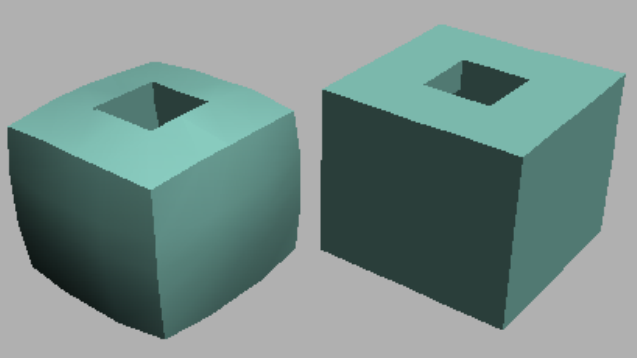
Box with Straighten Corners off (left) and on (right)
Skew Modifier
Modify panel > Make a selection. > Modifier List > Object-Space Modifiers >
Skew
Make a selection. > Modifiers menu > Parametric Deformers > Skew
The Skew modifier lets you produce a uniform offset in an object's geometry.
You can control the amount and direction of the skew on any of three axes.
You can also limit the skew to a section of the geometry.
1596 | Chapter 9 Modifiers
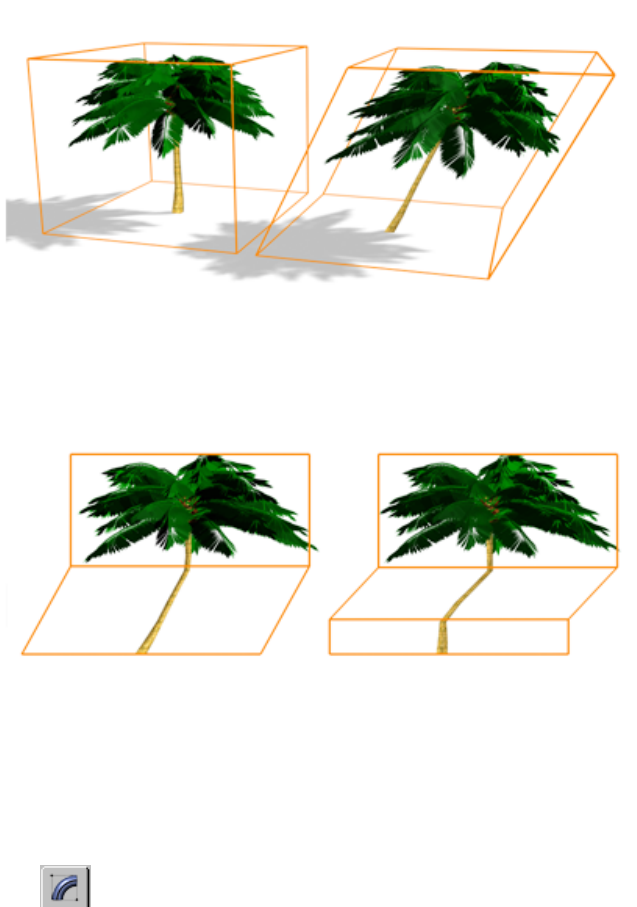
Skew modifier applied
Effect of moving modifier center with limits set
Procedures
To skew an object:
1 Select an object, go to the Modify panel, and choose Skew from
modifier list.
2On the Parameters rollout, set the axis of the skew to X, Y, or Z. This is
the axis of the Skew gizmo, not the axis of the selected object.
Skew Modifier | 1597
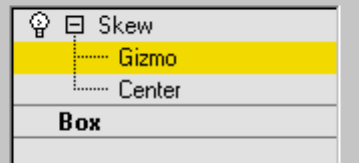
You can change the axis at any time, but only one axis setting is carried
with the modifier.
3Set the amount of the skew. The amount is an offset in current units
parallel with the axis.
The object skews to this amount beginning at the lower limit, by default
the location of the modifier's center.
4Set the direction of the skew.
The object swivels around the axis.
You can reverse the amount and direction by changing a positive value
to a negative value.
To limit the skew:
1Turn on Limits group > Limit Effect.
2Set values for the upper and lower limits. These are distances in current
units above and below the modifier's center, which is at zero on the
gizmo's Z axis. The upper limit can be zero or positive, the lower limit
zero or negative. If the limits are equal, the result is the same as turning
off Limit Effect.
The skew offset is applied between these limits. The surrounding
geometry, while unaffected by the skew itself, is moved to keep the object
intact.
3At the sub-object level, you can select and move the modifier's center.
The limit settings remain on either side of the center as you move it. This
lets you relocate the skew area to another part of the object.
Interface
Modifier Stack
1598 | Chapter 9 Modifiers
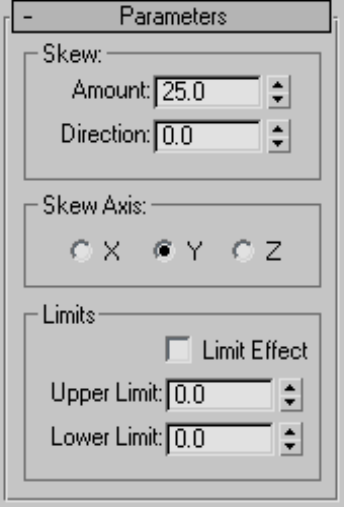
Gizmo At this sub-object level, you can transform and animate the gizmo
like any other object, altering the effect of the Skew modifier. Translating the
gizmo translates its center an equal distance. Rotating and scaling the gizmo
take place with respect to its center.
Center At this sub-object level, you can translate and animate the center of
the Skew effect.
For more information on the stack display, see Modifier Stack on page 7427 .
Parameters rollout
Skew group
Amount Sets the angle to skew from the vertical plane.
Direction Sets the direction of the skew relative to the horizontal plane.
Skew Axis group
X/Y/Z Specify the axis that will be skewed. Note that this axis is local to the
Skew gizmo and not related to the selected entity. Default=Z.
Skew Modifier | 1599
Limits group
Limit Effect Applies limit constraints to the Skew modifier.
Upper Limit Sets the upper limit boundaries in world units from the skew
center point, beyond which the skew no longer affects the geometry. Default=0.
Lower Limit Sets the lower limit boundaries in world units from the skew
center point, beyond which the skew no longer affects the geometry. Default=0.
Skin Modifier
Select a mesh, patch, or NURBS object. > Modify panel > Modifier List >
Object-Space Modifiers > Skin
Select a mesh, patch, or NURBS object. > Modifiers menu > Animation
Modifiers > Skin
The Skin modifier is a skeletal deformation tool that lets you deform one
object with another object. Mesh, patch, or NURBS objects can be deformed
by bones, splines, and other objects.
Applying the Skin modifier and then assigning bones gives each bone a
capsule-shaped "envelope." Vertices of the modified object within these
envelopes move with the bones. Where envelopes overlap, vertex motion is
a blend between the envelopes.
By default, each vertex that's affected by a single bone is given a weight value
of 1.0, which means it's affected by that bone only. Vertices within the
intersection of two bones' envelopes have two weight values: one for each
bone. And you can use Skin modifier toolsets such as the Weight Tool dialog
on page 1627 to arbitrarily assign vertices to any number of bones. The ratio of
a vertex's weight values, which always total 1.0, determine the relative extent
to which each bone's motion affects the vertex. For example, if a vertex's
weight with respect to bone 1 is 0.8 and its weight with respect to bone 2 is
0.2, then the motion of bone 1 will have four times greater influence on the
vertex than will the motion of bone 2.
The initial envelope shape and position depends on the type of bone object.
Bones create a linear envelope that extends along the longest axis of the bone
geometry. Spline objects create envelopes that follow the curve of the spline.
Primitive objects create an envelope that follows the longest axis of the object.
1600 | Chapter 9 Modifiers
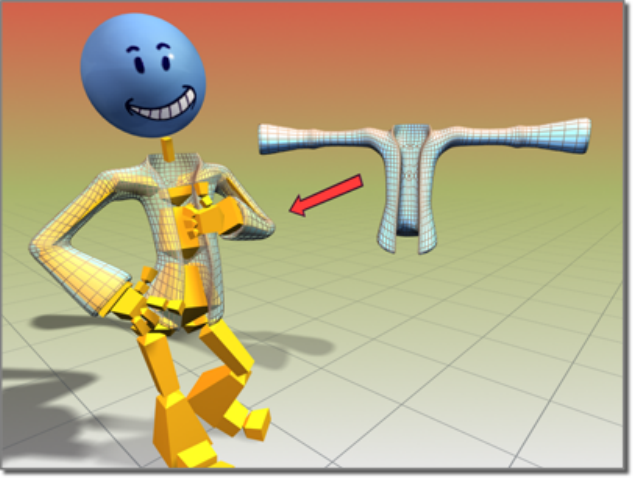
You can also deform the mesh based on the angle of the bones. Three
deformers let you shape the mesh based on bone angles:
■The Joint and Bulge Angle deformers use a lattice similar to an FFD lattice
on page 1383 to shape the mesh at a specific angle.
■The Morph Angle Deformer morphs the mesh at specified angles. Morph
targets are created by using modifiers above the Skin modifier in the stack,
or by using the Snapshot tool on page 921 to create a copy of the mesh
and deforming the mesh using standard tools.
You can apply the Skin modifier to several objects at the same time.
Jacket object deformed using the Skin modifier
In 3ds Max you can mirror envelope and vertex assignments from one side
of the mesh to the other with commands on the Mirror Parameters rollout.
Skin Modifier | 1601
Procedures
To use the Skin modifier:
1Prepare the skin (mesh or patch object) and skeleton (bones or other
objects). Carefully place the skeleton inside the mesh or patch object so
that its elements are able to influence polygons or patches in their
immediate vicinity.
2Select the mesh or patch object and apply the Skin modifier.
3In the Parameters rollout, click Add and choose the skeleton objects.
4Click Edit Envelopes and select an envelope to modify the volume in
which each bone can influence the surrounding geometry.
To weight vertices manually:
1On the Parameters rollout, turn on Vertices.
2On the mesh, select the vertices you would like to weight manually.
Each selected vertex is surrounded by a small white rectangle.
3highlight the name of the bone for which you want to change the vertex
weights.
4In the Weight Properties group, change the Abs. Effect parameter to the
new vertex weight.
To mirror envelope or vertex weight settings:
1Adjust envelopes and vertex weights on one side of the mesh.
2On the Mirror Parameters rollout, click Mirror Mode.
The mirror plane appears at the position and orientation of the mesh's
pivot point.
3If the mirror plane is not at the center of the mesh, change the Mirror
Offset parameter to move the plane to the center.
4If some vertices in the left or right side of the mesh are red rather than
blue or green, increase the Mirror Thresh value until all vertices are blue
or green.
5On the Mirror Parameters rollout, click the appropriate Paste button to
paste green or blue envelopes or vertex weights to the other side of the
mesh.
1602 | Chapter 9 Modifiers

To adjust the skin and/or bones without affecting the envelopes:
1Save the scene.
This is a potentially destructive operation, so it's best not to take any
chances with your data.
2Select the object to which the Skin modifier is applied.
3In the Advanced Parameters rollout, turn off Always Deform.
4Apply any necessary transforms to the mesh/patch object or bones objects.
5Turn Always Deform back on.
To adjust the bones only, you can also use skin pose on page 244 .
Example: To apply the Skin modifier to a cylinder with a bones skeleton:
1 On the Create panel, under Standard Primitives, click
Cylinder.
2In the middle of the Top viewport, click and drag 20 units to create the
base of the cylinder.
3Release the mouse button and drag up 130 units to establish the height
of the cylinder.
4On the parameters rollout, set Height Segments to 20.
This provides mesh detail for a smooth surface deformation.
5 On the Create panel, under Systems, click Bones.
Make sure an IK Solver is chosen in the IK Solver list. Turn on Assign To
Children. (This should turn on Assign To Root as well.)
6In the Front viewport, click successively three times: below the cylinder,
in the middle of the cylinder, and above the top of the cylinder.
7Right-click to end Bones creation.
Three bones display. Two of them are within the middle of the cylinder.
8 Select the cylinder.
Skin Modifier | 1603
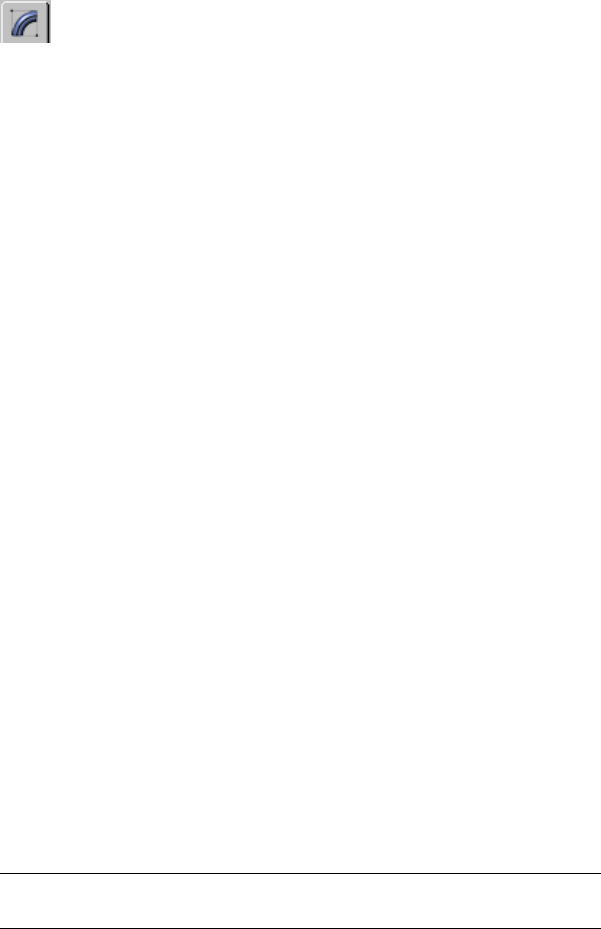
9 On the Modify panel, choose Skin from the Modifier List.
10 On the Skin modifier's Parameters rollout, click Add, and use the Select
Bones dialog to select the three bones.
The names of the bones are now displayed in the list.
11 In the Front viewport, select the bone end effector (IK Chain01) and
move it around.
The cylinder deforms to follow the bones. To adjust envelopes to refine
the surface deformation, choose the Skin modifier's Envelope sub-object
level, and use the Edit Envelopes controls to resize envelopes and change
vertex weights.
Example: To use a morph angle deformer:
Create the cylinder and bones from the preceding procedure before you
continue with this procedure.
1At frame 50, animate bone 2 so that bones 1 and 2 represent a 90-degree
angle.
2At frame 0, the bones should be straight at about a 180-degree angle.
3Move to frame 0.
4Turn on Edit Envelopes in the Parameters rollout.
5Select the child bone (bone 2) in the modifier's list of bones.
6In the Select group, turn on Vertices.
This allows you to select vertices.
7In the viewports, region-window select a good portion of the vertices
that are controlled by both bones.
8In the Gizmos rollout, select the Morph Angle Deformer in the drop-down
list, and then click Add Gizmo.
The Deformer Parameters rollout displays. A base morph target is the first
and only target in the list.
TIP if the Deformer doesn't assign, make sure that bone 2 and not bone 1
is selected in the list.
9Scrub the Time Slider to frame 50.
1604 | Chapter 9 Modifiers

10 Add an Edit Mesh modifier above the Skin modifier in the modifier stack.
11 Turn on Vertex and Soft Selection in the Edit Mesh modifier.
12 Edit the mesh to the shape you want.
13 Go back down in the stack to the Skin modifier. If the topology warning
dialog appears, click Yes.
14 In the Deformer Parameters rollout, click Add From Stack.
A new morph target is added at about 90 degrees.
15 Delete the Edit Mesh modifier from the stack.
There is a doubling effect of the morph if you don’t delete or deactivate
the Edit Mesh modifier.
16 Scrub the time slider. The mesh morphs as the bone angle changes.
Interface
The Skin Modifier interface includes the following rollouts:
■Parameters rollout on page 1606
■Mirror Parameters rollout on page 1612
■Display rollout on page 1614
■Advanced Parameters rollout on page 1616
■Gizmos rollout on page 1618
■Deformer Parameters rollout on page 1621
■Joint Angle and Bulge Angle parameters on page 1623
Some of the Skin modifier commands are also available from the quad menu
on page 7300 .
Modifier Stack
Envelope Turn on this sub-object level to work on envelopes and vertex
weights.
TIP You can use the quad menu to choose this sub-object level.
Skin Modifier | 1605

Parameters rollout
Edit Envelopes Use this sub-object level to work on envelopes and vertex
weights.
1606 | Chapter 9 Modifiers
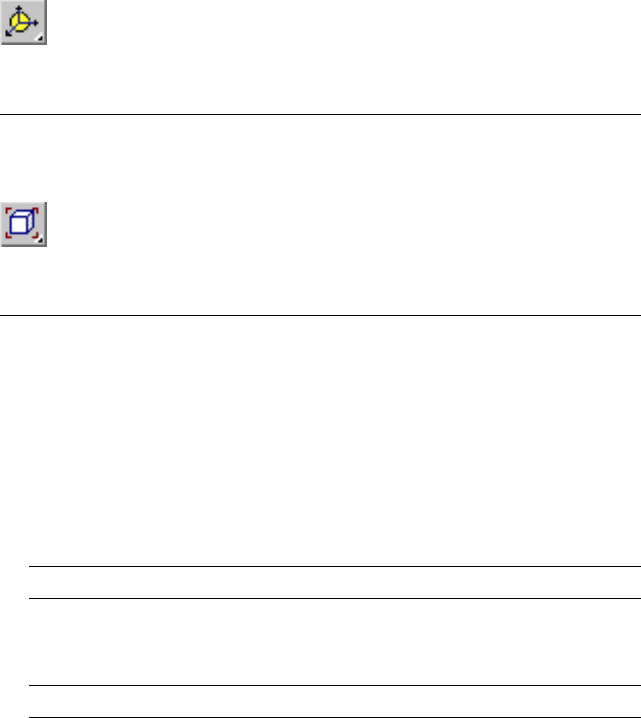
Select group
The following filtering options are grouped together to help you work on a
particular task, by preventing you from accidentally selecting the wrong item
in the viewports.
Vertices Turn on for vertex selection.
You can rotate around selected vertices using Arc Rotate SubObject on
page 7395 from the Arc Rotate flyout on page 7394 . You can also rotate around
a selected envelope as long as no vertices are selected, as they have precedence.
NOTE You must choose Use Selection Center on page 907 from the User Center
flyout on page 904 to center on your selection. If you choose Use Pivot Point
Center on page 905 , arc rotate is centered on the selected bone/cross section.
You can zoom on selected vertices using Zoom Extents Selected on page
7387 from the Zoom Extents flyout. You can also zoom on an envelope if no
vertices are selected.
■Shrink Modifies the current vertex selection by progressively subtracting
the outermost vertices from the selected object. Has no effect if all the
vertices from an object are selected.
■Grow Modifies the current vertex selection by progressively adding
neighborhood vertices of the selected object. You must start with at least
one vertex to be able to grow your selection.
■Ring Expands the current vertex selection to include all vertices part of
parallel edges.
NOTE You must select at least two vertices to use the Ring selection.
■Loop Expands the current vertex selection to include all vertices part of
continuing edges.
NOTE You must select at least two vertices to use the Ring selection.
■Select Element When on, selects all vertices of the element you select,
as long as you select at least one vertex from that element.
Skin Modifier | 1607
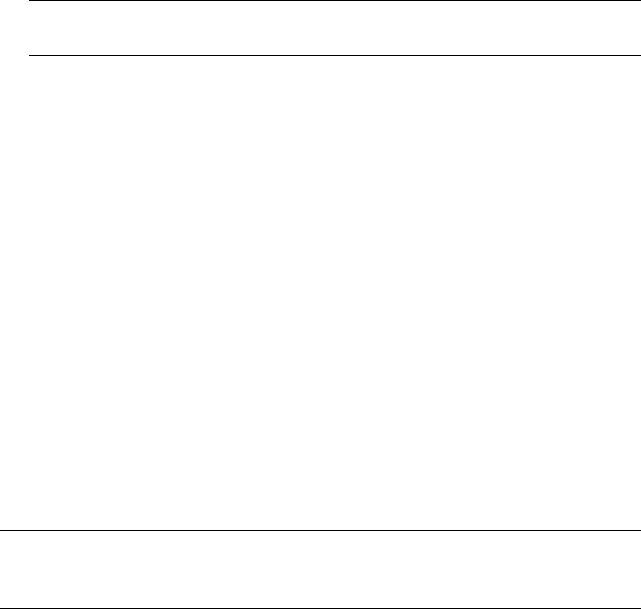
TIP You can edit your selection by holding Ctrl or Alt, and then select vertices.
This adds or removes, respectively, vertices to or from your selection.
■Backface Cull Vertices When on, you cannot select vertices pointing
away from the current view (on the other side of the geometry).
Envelopes Turn on for envelope selection.
Cross Sections Turn on for cross-section selection.
The first step, after applying the Skin modifier to an object, is to determine
which bones participate in the object's weighting. Every bone you choose
influences the weighted object with its envelope, which you can configure in
the Envelope Properties group on page 1609 .
Add Click to add one or more bones from the Select Bones dialog.
Remove Choose a bone in the list, and then click Remove to remove it.
[list window] Lists all bones in the system. Highlighting a bone in the list
displays that bone's envelope and the vertices influenced by the envelope.
An horizontal scroll bar appears if a bone's name is longer than the window's
width.
NOTE If an older scene containing long bone names is loaded in 3ds Max, its
name is truncated to fit in the window. You can overwrite this by setting the
MAXScript shortenBoneNames property of your Skin modifier to false.
Example: $'Sphere01'.modifiers[#Skin].shortenBoneNames = false
For detailed information about the MAXScript utility, open the MAXScript
Reference, available from Help menu > MAXScript Reference.
[bone name type-in field] Enter a bone name to highlight it in the bone list
above. The highlighting goes to the first matching bone.
Use these methods for finding bone names faster:
■Narrow the list by typing the first few characters in the name of the bone
you want to highlight.
■Use the wildcard (*) key. For example, you can find Robot R Index Finger by
typing * R In
1608 | Chapter 9 Modifiers
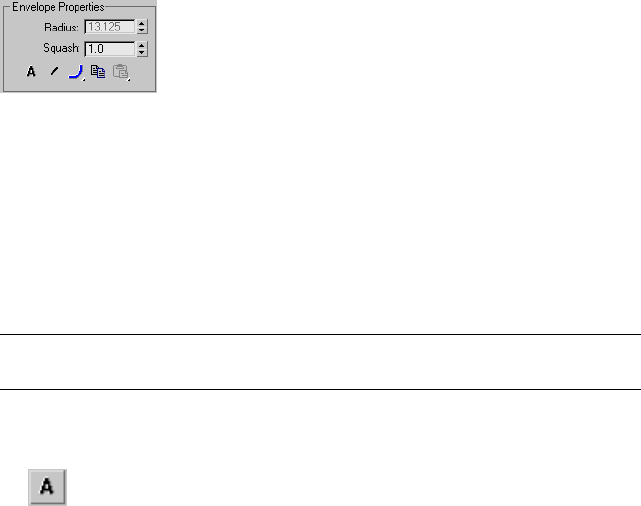
Cross Sections group
By default, each envelope has two round, lateral cross sections, one at each
end of the envelope. These options add and remove cross sections from
envelopes.
Add Choose a bone in the list, click Add, and click a position on the bone
in a viewport to add a cross section.
Remove Select an envelope cross section and click Remove to delete it.
Before you can select a cross section, the Cross Sections option in the Select
group must be on.
You can delete only extra cross sections that you have added; not the default
cross sections.
Envelope Properties group
Radius Select an envelope cross section, and use Radius to resize it. In order
to select a cross section, the Cross Sections option in the Select group must
be checked.
You can also click and drag a cross section control point in a viewport to resize
it.
Squash A squash multiplier for bones that stretch. This is a single value that
reduces or increases the amount of squash applied to a bone when it is
stretched with Freeze Length off, and Squash on.
NOTE You can set Freeze Length and Squash in the Bone Tools dialog on page
851 .
Absolute/Relative This toggle determines how vertex weights are calculated
for vertices between inner and outer envelopes.
■Absolute A vertex must merely fall inside the brown outer envelope
to have 100% assignment weight to that particular bone. A vertex falling
inside more than one outer envelope will be assigned multiple weights
summing to 100% based on where it falls in the gradients of each envelope.
Skin Modifier | 1609

■Relative A vertex falling only within an outer envelope will not
receive 100% weighting. A vertex must either fall inside two or more outer
envelopes whose gradients sum to 100% or greater or the vertex must fall
within a red inner envelope to have 100% weight. Any points within a red
inner envelope will be 100% locked to that bone. Vertices falling within
multiple inner envelopes will receive weighting distributed over those
bones.
Envelope Visibility Determines the visibility of unselected
envelopes. Choose a bone in the list and click Envelope Visibility, then choose
another bone in the list. The first bone selected remains visible. Use this to
work on two or three envelopes.
Falloff Flyouts Choose a falloff curve for the displayed envelopes.
Weight falls off in the area between the inner and outer envelope boundaries
if envelopes overlap and Absolute is turned on. This setting lets you specify
how the falloff is handled:
■Falloff Fast Out Weight falls off quickly.
■Falloff Slow Out Weight falls off slowly.
■Falloff Linear Weight falls off in a linear way.
■Falloff Sinual Weight falls off in a sinusoidal way.
Copy Copies the currently selected envelope size and shape to memory.
Turn on sub-object Envelopes, choose one bone in the list, click Copy, then
choose another bone in the list and click Paste to copy an envelope from one
bone to another.
Paste commands are on a flyout with the following options:
■Paste Pastes the copy buffer to the current selected bone.
■Paste to All Bones Pastes the copy buffer to all bones in the modifier.
1610 | Chapter 9 Modifiers

■Paste to Multiple Bones Pastes the copy buffer to selected bones. A
dialog allows you to choose the bones to paste to.
Weight Properties group
Abs. Effect Enter an absolute weight for the selected bone to selected vertices.
Choose the Envelope sub-object level, turn on Vertices in the Parameters
rollout > Select group, select a vertex or vertices, and then use the Abs. Effect
spinner to assign weight. Selected vertices move in the viewports as their
weight changes.
Rigid Causes selected vertices to be influenced only by one bone, the one
with the most influence.
Rigid Handles Causes the handles of selected patch vertices to be influenced
by only one bone, the one with the most influence.
Normalize Forces the total weights of each selected vertex to add up to 1.0.
Exclude Selected Verts Adds the currently selected vertices to the
exclusion list for the current bone. Any vertices in this exclusion list will not
be affected by this bone.
Include Selected Verts Takes the selected vertices out of the exclusion
list for the selected bone. The bone can then affect these vertices.
Select Excluded Verts Selects all vertices excluded from the current
bone (see Exclude Selected Verts, preceding).
Skin Modifier | 1611
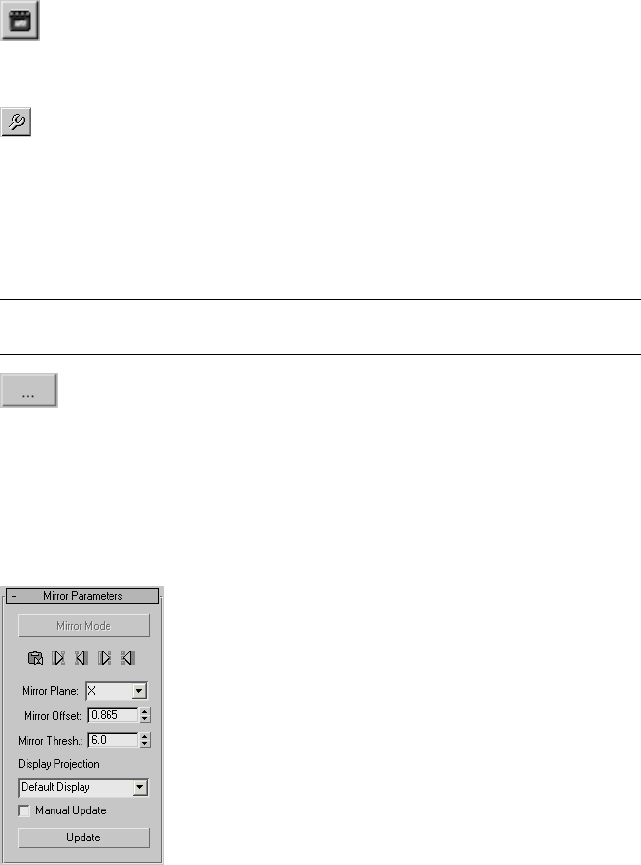
Bake Selected Verts Click to bake the current vertex weights. Baked
weights are not affected by envelope changes, only by changes to Abs. Effect
on page 1611 or weights in the Weight Table on page 1633 .
Weight Tool Displays the Weight Tool dialog on page 1627 , which offers
control tools to help you assign and blend weights on selected vertices.
Weight Table Displays a table for viewing and changing weights for all bones
in the skeletal structure. See Weight Table on page 1633 .
Paint Weights Click and drag the cursor over vertices in the viewports to
brush on weights for the selected bone.
TIP Streamline the painting process by using the Brush Presets tools on page 7293
.
Painter Options [ellipsis] Opens the Painter Options dialog on page
1907 , where you can set parameters for weight painting.
Paint Blend Weights When on, blends painted values by averaging the
weights of neighboring vertices and then applying the average weight based
on the brush strength. Default=on.
Mirror Parameters rollout
Mirror Mode Activates Mirror mode, which lets you mirror the envelopes
and vertex assignments from one side of the mesh to the other. This mode is
available only at the Envelope sub-object level.
1612 | Chapter 9 Modifiers
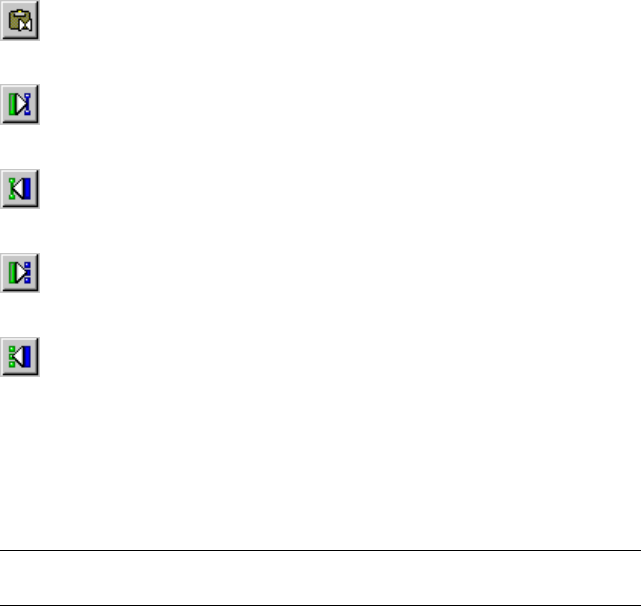
Mirror mode uses the Mirror Plane setting to determine the “left side” and
“right side” of the mesh. When you turn on Mirror Mode, the vertices on the
left side of the mirror plane turn blue, while the vertices on the right turn
green. Vertices that are neither left nor right turn red, including vertices at
the mirror plane. If vertices don't change color appropriately, you might have
to increase the Mirror Thresh value to expand the range used to determine
the left and right sides.
If you select vertices or bones, the selected vertices or bones turn yellow, and
the corresponding match on the other side of the mesh turns a brighter blue
or green. This can help you check for matches.
Mirror Paste Pastes selected envelope and vertex assignments to the
opposite side of the body.
Paste Green to Blue Bones Pastes the envelope settings from green
bones to blue.
Paste Blue to Green Bones Pastes the envelope settings from blue
bones to green.
Paste Green to Blue Verts Pastes the individual vertex assignments
from all green vertices to the corresponding blue vertices.
Paste Blue to Green Verts Pastes the individual vertex assignments
from all blue vertices to the corresponding green vertices.
Mirror Plane Determines the plane that will be used to determine the left
and right sides. The plane appears in the viewport at the mesh's pivot point
when you turn on Mirror mode. The selected mesh's local axes are used as the
basis for the plane. If several objects are selected, one object's local axes are
used. Default=X.
TIP For the easiest workflow with mirroring tools for the Skin modifier, set the
pivot points for character meshes to align with the World before applying Skin.
Mirror Offset Shifts the mirror plane along the Mirror Plane axis.
Mirror Thresh Sets the relative distance the mirroring tools will look when
setting vertices as left or right. If some vertices in the mesh (other than those
at the mirror plane) are not colored blue or green when you turn on Mirror
mode, increase the Mirror Thresh value to include a larger area of the character.
Skin Modifier | 1613
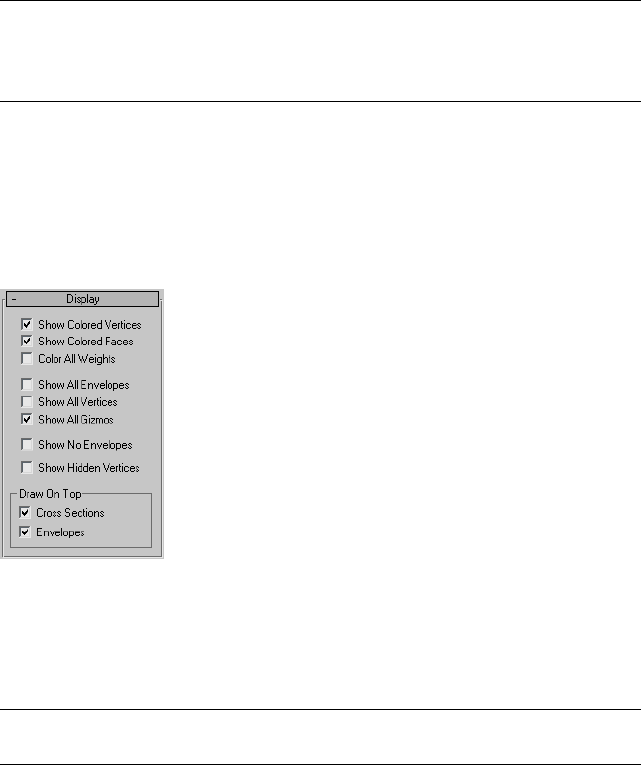
You can also increase this value to compensate for lack of symmetry in
asymmetrical models.
Display Projection When Display Projection is set to Default Display, selecting
vertices on one side of the mirror plane automatically projects the selection
to the opposite side. The Positive and Negative options allow selection of
vertices on one side of the character only. The None option does not project
selected vertices to either side. Default=Default Display.
TIP You can use the Positive and Negative options to temporarily project the
display of one side's vertices to the other side so you can see how the vertices
align. This can be helpful when determining the correct Mirror Plane settings for
an asymmetrical mesh.
Manual Update When on, you can update the display manually rather than
automatically after each mouse-up.
Update When Manual Update is on, use this button to update the display
with your new settings.
Display rollout
Show Colored Vertices Colors vertices in viewports according to their weights.
Show Colored Faces Colors faces in viewports according to their weights.
Color All Weights Assigns a color to every bone in the envelope. The vertex
weighting blends the colors together.
TIP You can toggle this feature to get a global view of all weight regions across
your model at once.
1614 | Chapter 9 Modifiers

TIP You can also assign a color to unweighted vertices: Open the Customize User
Interface dialog and, on the Colors panel, choose Skin Colors from the Elements
drop-down list.
Show All Envelopes Displays all envelopes at the same time.
Show All Vertices Draws a small tick at every vertex. On a patch surface, it
will also draw all the handles.
Show All Gizmos Displays all the gizmos in addition to the currently selected
gizmo.
Show No Envelopes Causes no envelopes to be displayed even when an
envelope is selected.
Show Hidden Vertices When on, hidden vertices are visible. Otherwise, they
remain hidden until you enable the option or go into the object's modifier (
Editable Mesh on page 1990 or Editable Poly on page 2055 ), and then click
Unhide All on the Selection rollout or Edit Geometry rollout, respectively.
Default=off.
Draw On Top group
These options determine which elements will be drawn on top of all other
objects in viewports.
Cross Sections Forces cross sections to be drawn on top.
Envelopes Forces envelopes to be drawn on top.
Skin Modifier | 1615
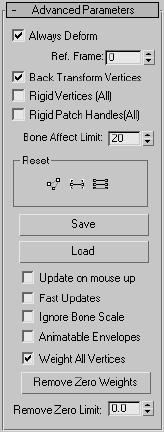
Advanced Parameters rollout
Always Deform A toggle useful for editing the transformation relationship
between bones and the controlled points. This relationship is initially set
when Skin is applied. To change the relationship the user can deactivate
Always Deform, move the object or the bones and reactivate. The new
transformation relationship is now used.
Ref. Frame Sets the frame where the bones and the mesh are in a reference
position.
Normally this is frame 0. Start your animation at frame 1 or later if frame 0 is
the reference frame. If bones need to be adjusted relative to the mesh, move
the time slider to frame 0; turn off Always Deform, move the bones into the
correct position and turn on Always Deform.
Back Transform Vertices Allows you to link the mesh to the bone structure.
Ordinarily, when you do this, any movement of the bones causes the mesh
to move twice as far as it should, because it moves once with the bones and
once with the link. Checking this option prevents the mesh from moving
twice under these circumstances.
Rigid Vertices (All) Causes vertices to have assignments to only one bone as
if weighted 100% to the bone whose envelope has the most influence. Vertices
will not have weight distributed over more than one bone and the deformation
1616 | Chapter 9 Modifiers
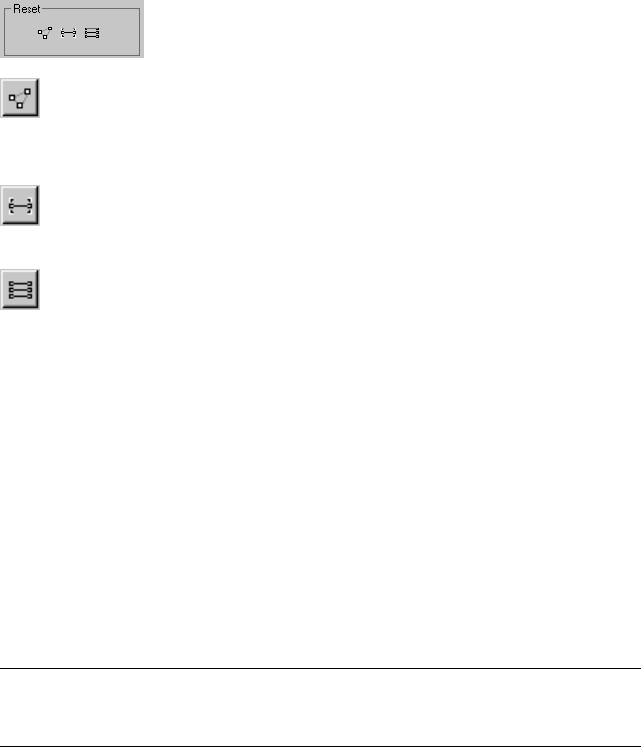
of the skinned object is rigid. This is mainly used for games that do not support
weighted point transformation.
Rigid Patch Handles (All) On a patch model, forces patch handle weights to
equal the knots weights.
Bone Affect Limit Limits the number of bones that can affect one vertex.
Reset group
Reset Selected Verts Resets the weight of selected vertices to the
envelope defaults. After manually changing vertex weight, use this to reset
weights if necessary.
Reset Selected Bone Resets associated vertex weights back to the
original weights calculated for the selected bone's envelope.
Reset All Bones Resets all vertex weights back to the original weights
calculated for all bone's envelopes.
Save/Load Allows you to save and load the envelope position and shape, as
well as the vertex weights. If you load a saved file onto a different system of
bones, you can use the Load Envelopes dialog on page 1624 to match the
incoming bones to the current bones.
Update on mouse up When on and the mouse button is pressed down, no
updates take place. When the mouse button is released, updates occur. This
option helps keep workflow moving quickly by avoiding unnecessary updates.
Fast Updates Turns off viewport display of weighted deformation and gizmos
and uses rigid deformation when not rendering.
Ignore Bone Scale Turn this option on to leave a skinned mesh unaffected
by a scaled bone. Default=off.
NOTE To scale a bone's length, you first need to turn off its Freeze Length option
on the Object Properties rollout on page 851 of the Bone Tools floater dialog on
page 845 .
Skin Modifier | 1617
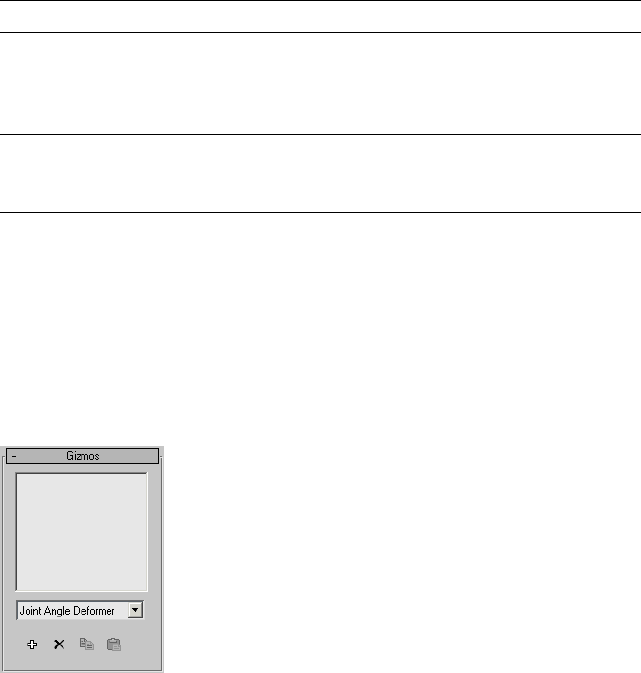
Animatable Envelopes Toggles the possibility of creating keys on all
animatable envelope parameters while Auto Key is active. Default=off.
NOTE This does not affect keyable track settings.
Weight All Vertices When on, forces all vertices that are not under the control
of an envelope to be weighted to the bone closest to them. Has no effect on
vertices that are manually weighted. Default=on.
TIP If you want to revert vertices to their original weight value, click Reset Selected
Verts (in the Reset group) or open the Weight Table on page 1633 , and change
the Modified weight status (M) of your selected vertices.
Remove Zero Weights Strips a vertex from its weight if it is less than the
Remove Zero Limit value. This helps making your skinned model lighter (in
games for instance) because less unnecessary data is stored in the geometry.
Also accessible from the Weight Table.
Remove Zero Limit Sets the weight threshold that determines if a vertex is
stripped of its weight when you click Remove Zero Weights. Default=0.0.
Gizmos rollout
Controls in the Gizmos rollout allow you to deform the mesh according to
the angle of the joint, and to add gizmos to selected points on the object. The
rollout consists of a list box containing all the gizmos for this modifier, a
drop-down list of the current types of gizmos, and four buttons (Add, Remove,
Copy and Paste).
The workflow for adding a gizmo is to select the vertices that you want to
affect, select the bones that will drive the deformation, and then click the Add
button.
1618 | Chapter 9 Modifiers
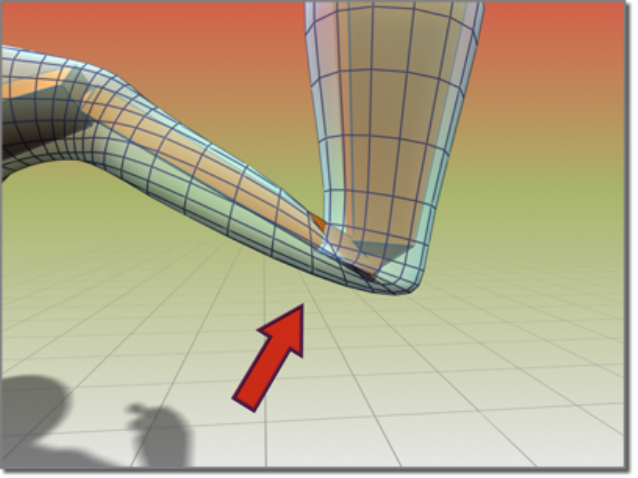
There are three deformers available:
■The Joint Angle deformer has a lattice that can deform vertices on the
parent and child bones.
■The Bulge Angle deformer has a lattice that only works on vertices on the
parent bone.
■The Morph Angle deformer works on vertices of the parent and child bones.
Keep these distinctions in mind when you select vertices to deform. For
example, if you want to use the Joint Angle deformer, then select vertices
close to the joint that will drive the deformation. If you want the parent
bone vertices to deform like a biceps muscle, then select vertices that are
only assigned to the parent bone before adding the Bulge Angle deformer.
If all the vertices of the parent and child bone must deform, then select
all of the vertices and add the Morph Angle deformer.
Bending the arm without the Morph Angle deformer causes the sleeve to crumple.
Skin Modifier | 1619
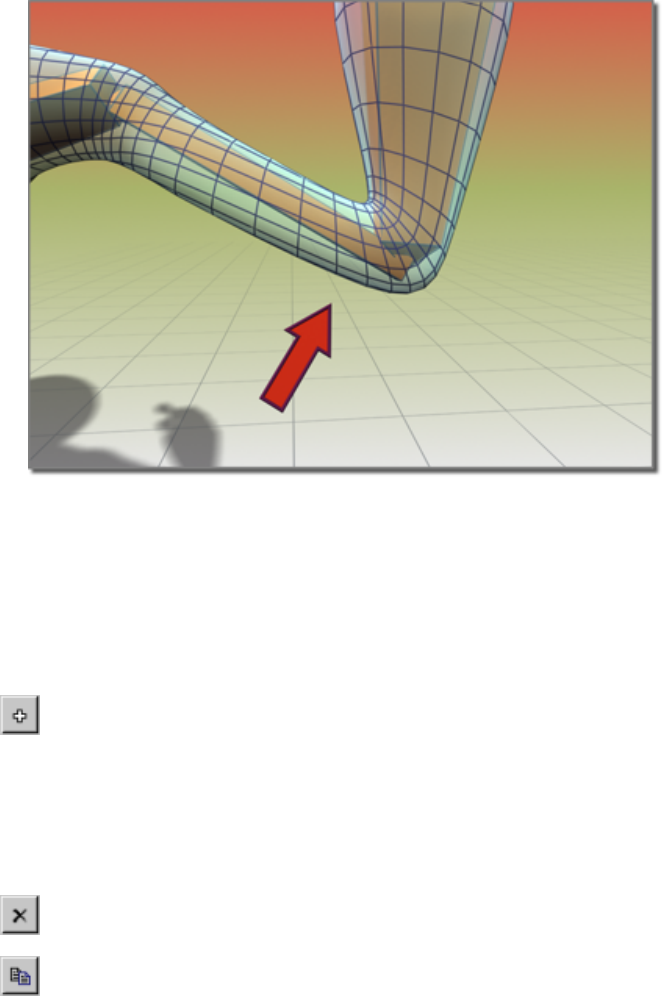
Using the Morph Angle deformer creates a smooth bend in the sleeve.
Gizmo List Window Lists the current Angle Deformers.
The Deformer Parameters rollout changes depending on the type of gizmo
selected.
Deformer drop-down list Lists the available deformers.
Add Gizmo Adds the current Gizmo to the selected vertices.
To add a gizmo, you must first select the child bone for the joint you want to
deform. Then you must select the vertices that you want to deform. You can
then add a gizmo.
After a gizmo is added, a Deformer Parameters rollout displays that contains
gizmo parameters that you can adjust.
Remove Gizmo Remove the selected gizmo from the list.
Copy Gizmo Copy the selected gizmo.
1620 | Chapter 9 Modifiers
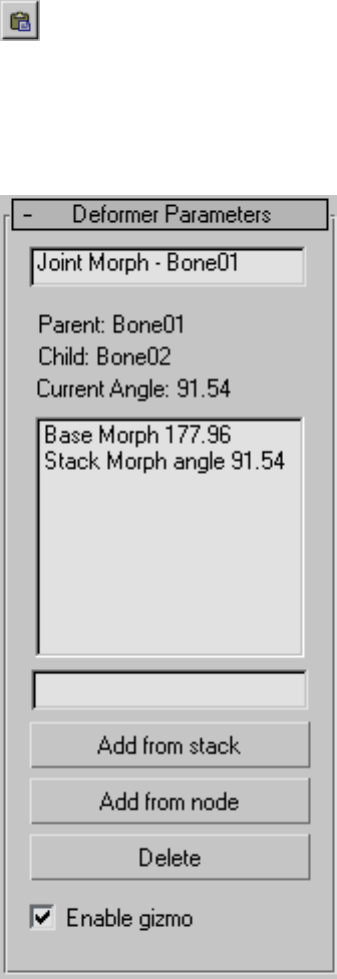
Paste Gizmo Paste the gizmo.
The Paste button pastes the current copy buffer into the currently selected
gizmo. You can only paste to like gizmos. For instance, you can't paste from
a bulge gizmo to a joint gizmo.
Deformer Parameters rollout
Skin Modifier | 1621

The following parameters are for the Morph Angle deformer. One way to create
morph targets, after the morph gizmo is added, is to add an Edit Mesh modifier
to the stack above the Skin modifier. Use the vertex controls in the Edit Mesh
modifier to shape the geometry. Then go back in the stack to the Skin modifier
and click Add From Stack. You can then delete the Edit Mesh modifier. Add
From Stack looks at the last modifier in the stack to get the morph target. Note
that when you go back down to the Skin modifier, the morph effect is doubled;
you can rectify this by deleting or deactivating the Edit Mesh modifier.
Joint Field Displays the type of Deformer and the associated bone.
List Window Contains the current morph targets and associated bone angles.
Naming Field Select a morph target and rename it in this field.
Add from stack Uses the current state of the stack to get the morph target.
Ideally, you have put an Edit Mesh modifier on top of the stack and done
your edits before you click Add From Stack.
Add from node Uses another object as your morph target for this angle. This
is like a regular morph target, but instead of being driven by a field, it is driven
by the joint angle.
TIP You can use Snap Shot on the main toolbar to create a new target for
morphing.
Delete Deletes the currently selected morph target from the list.
Enable gizmo Toggles the effect of the gizmo.
1622 | Chapter 9 Modifiers
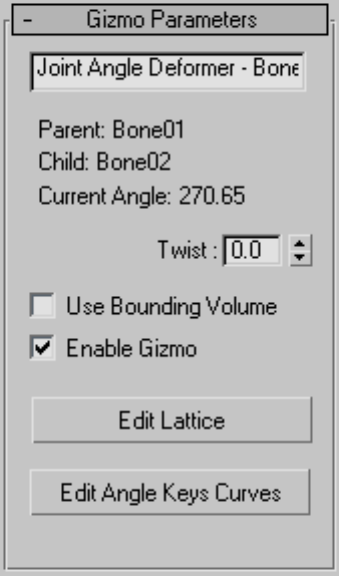
Joint Angle and Bulge Angle parameters
The following parameters are for the Joint Angle and Bulge Angle deformers.
These two deformers are almost identical in the way they operate. The
difference is that the Bulge Angle deformer only works on vertices of the parent
bone, while the Joint Angle deformer works on vertices on both the child and
parent bone.
To apply either of these deformers, first select the child link, then select vertices
on the mesh, and then apply the deformer. Remember to turn on Vertices in
the Parameters rollout > Select group before region-selecting vertices in the
viewports.
Once the deformer is applied, turn on Edit Lattice and move the lattice control
points in the viewports to deform the mesh at different bone angles.
Name Field Allows you to change the name of the deformer.
Twist Allows you to spin the gizmo around the mesh to place control points
appropriately.
Skin Modifier | 1623
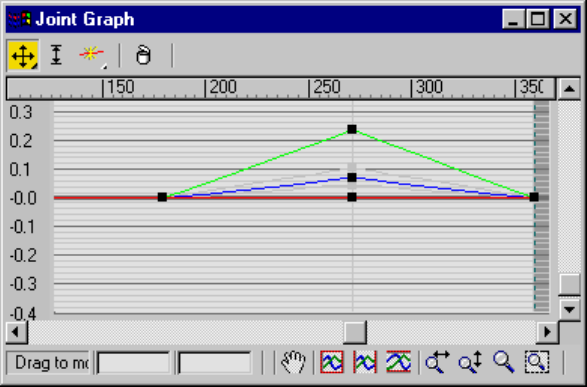
Use Bounding Volume Turn this on if you plan to change the geometry, like
increasing segments on a cylinder. If the geometry changes, the mesh will
still deform inside the lattice if this is turned on.
Enable Gizmo Toggles the effect of the gizmo on and off.
Edit Lattice Allows you to move the lattice control points in the viewports.
Edit Angle Keys Curves Brings up a curve editor that lets you manipulate
the shape of the lattice at a particular angle. This curve is position vs. angle.
It will show you the curves of the current selected points. The red curves are
X, green curves are Y, and blue curves are Z.
Load Envelopes Dialog (Skin Modifier)
Select a mesh, patch, or NURBS object. > Apply Skin modifier. > Advance
Parameters rollout > Load button
The Load Envelopes dialog associated with the Skin modifier on page 1600
allows you to load saved envelopes on page 1617 to specific bones. This resizable
dialog shows the current envelopes in your scene and the incoming envelopes.
Use the controls to manipulate the incoming envelopes so they align with
the current envelopes.
1624 | Chapter 9 Modifiers
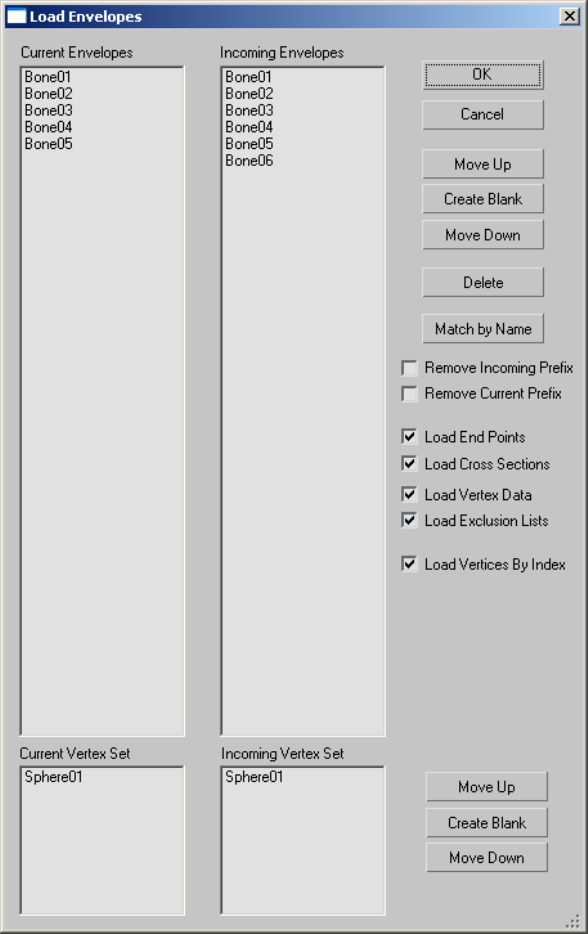
Interface
Skin Modifier | 1625
OK Accepts any changes and closes the dialog.
Cancel Discards any changes and closes the dialog.
Move Up/Down Move the current selection in the incoming list up or down.
Create Blank Creates space in the Incoming list.
Use this when loading data onto a skeleton that is not identical as the one
from which the data was saved. For example, if your original skeleton had
three fingers and the new one has only two fingers, you might need to add
spaces in the list to line up the fingers correctly.
Delete Removes the current selected incoming envelopes.
Match by Name Resorts the Incoming list and matches any bones that have
the same name in the list of current envelopes.
Remove Incoming Prefix Removes any prefixes on the names of the incoming
envelopes.
Remove Current Prefix Removes any prefixes on the names of the current
envelopes.
Load End Points Loads the envelope end point positions.
Load Cross Sections Loads the envelope cross sections.
Load Vertex Data When on, loads weights at the vertex level. Normally only
the envelope data is loaded so any manual adjustments to the vertex data are
lost. This option lets you load those manual edits.
Load Exclusion Lists Lets you also load user-generated exclusion-list data,
which specifies that certain vertices should not be affected by certain bones.
See Exclude Selected Verts on page 1611 and Show Exclusions on page 1635 .
Load Vertices By Index Lets you load vertices by index rather than vertex
position. You would typically use this option with identical meshes that have
not undergone any type of topology change. This should be off if you've
changed the topology, by, for instance, deleting or adding vertices or changing
their order.
Current Incoming Vertex Set
When Load Vertex Data is on, use these controls to match vertex sets in cases
where the Skin modifier is instanced. In such cases you might need to set up
several vertex sets.
The Move Up/Create Blank/Move Down buttons have the same functions as
in the Envelopes lists.
1626 | Chapter 9 Modifiers
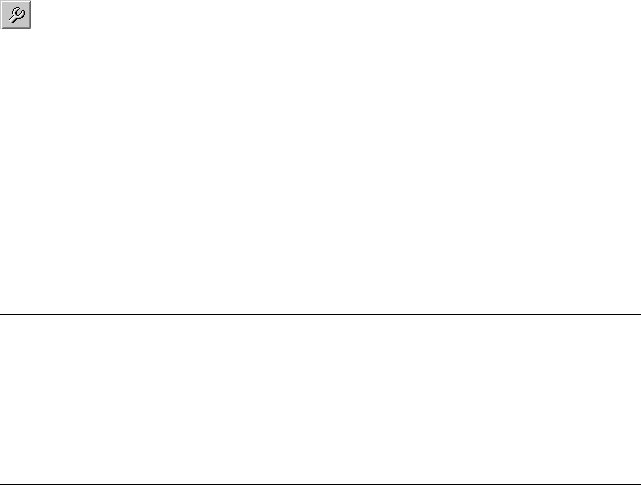
Weight Tool Dialog
Select an object that has the Skin modifier applied to it. > Modify panel > Skin
modifier > Parameters rollout > Weight Properties group > Weight Tool button
This dialog is launched from the Skin modifier on page 1600 and provides tools
to select vertices and assign them weights. You can also copy, paste, and blend
weights between vertices. Each vertex you select displays the objects
contributing to its weighting in the dialog list.
To use these tools, Parameters rollout > Edit Envelopes must be on, Parameters
rollout > Select group > Vertices must be on, and at least one vertex must be
selected.
IMPORTANT The controls on this dialog adjust vertex weighting with respect to
the active bone; that is, the object highlighted in the Bones list on the Parameters
rollout. When you select a vertex and then change its weighting, if the active bone
does not already influence the vertex, the bone is added to the list of bones
influencing the vertex. You can ensure that bone assignments don't change by
highlighting the bone in the Weight Tool dialog list after selecting the vertex and
before changing weighting.
Also, the total weighting for all bones influencing a vertex is always 1.0, so if
multiple bones influence a vertex and you change the weight value for one
bone, the weight values for the others change as well.
Procedures
Example: To Set and Blend Weights on Selected Vertices:
1Prepare a cylinder skinned to a bone chain.
Skin Modifier | 1627
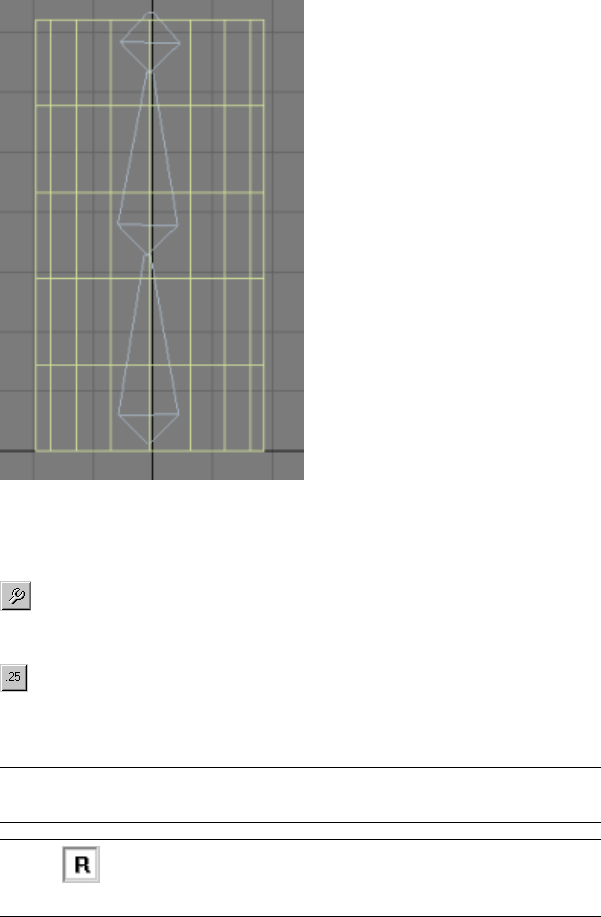
2On Parameters rollout of the Modify panel, turn on Edit Envelopes.
3Turn on Vertices in the Select group.
4 In the Weight Properties group, click Weight Tool.
The Weight Tool dialog opens.
5 Select a few vertices and then click the .25 weight button.
The selected vertices are weighted at 0.250 for the active bone (highlighted
in the Parameters rollout list), coloring them yellow.
NOTE The active bone is added to the list of bones influencing each of the
selected vertices, if necessary.
NOTE You might need to toggle the vertex weighting to Relative in
the Envelope Properties group on page 1600 .
1628 | Chapter 9 Modifiers
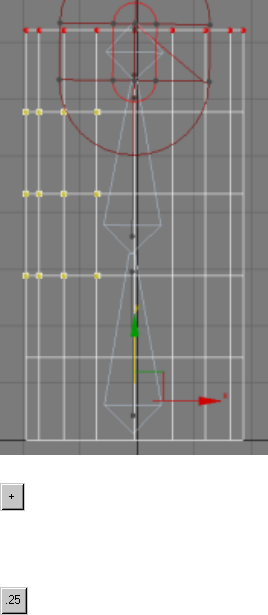
6 Click the + button directly under the .9 weight button repeatedly
until the vertices are red (that is, the weight is 1.0).
As you increase the vertices' weight, they gradually change color.
7 Select a few other vertices, and assign them a weight of 0.250.
Skin Modifier | 1629
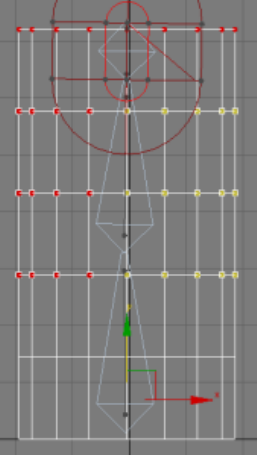
The left vertices are weighted 1.0 and the right vertices are weighted 0.25.
8Select all weighted vertices and repeatedly click Blend.
Every time you click Blend, each vertex's weight is adjusted to blend with
other selected neighborhood weights. This creates a smooth weighting
transition among all selected vertices.
1630 | Chapter 9 Modifiers
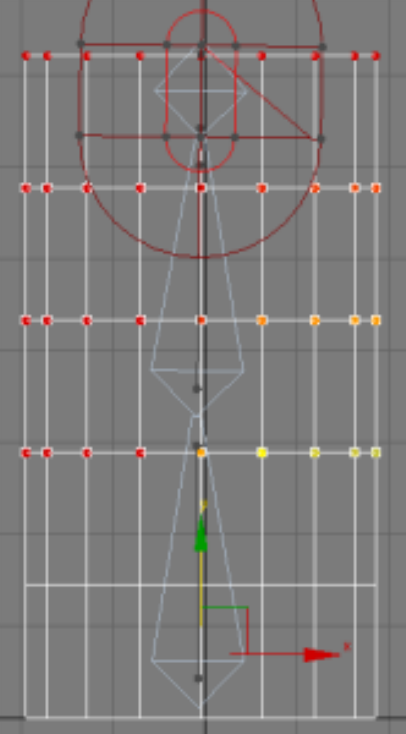
The two separate colors blend into a smooth gradient.
Skin Modifier | 1631
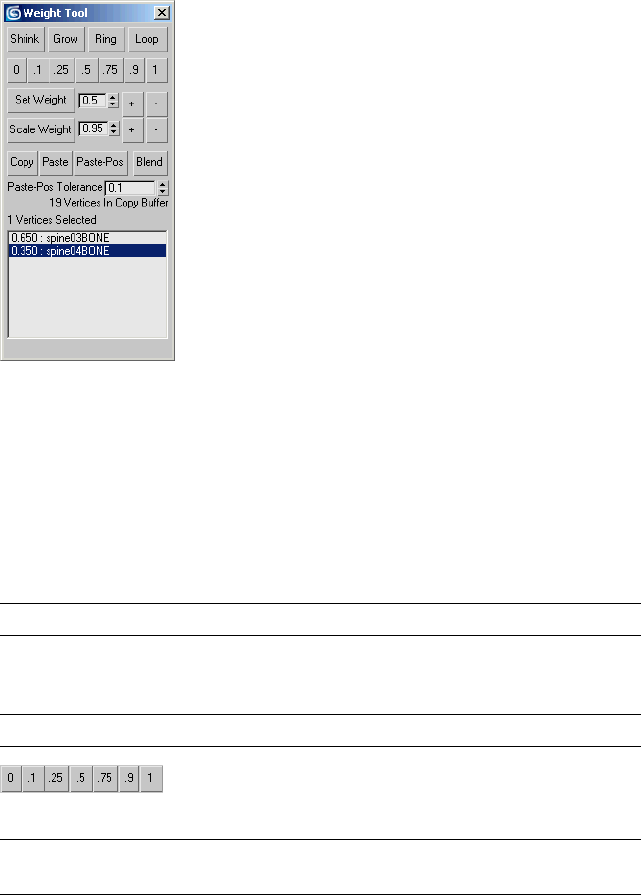
Interface
Shrink Modifies the current vertex selection by progressively subtracting the
outermost vertices from the selection. Has no effect if all vertices in an object
are selected.
Grow Modifies the current vertex selection by progressively adding
neighborhood vertices of the selected object. You must start with at least one
vertex to be able to grow your selection.
Ring Expands the current vertex selection to include all vertices in parallel
edges.
NOTE You must select at least two vertices to use the Ring selection.
Loop Expands the current vertex selection to include all vertices in
continuing edges.
NOTE You must select at least two vertices to use the Loop selection.
[specific weight values] Assigns an absolute weight value
between 0 and 1 for the active bone to the selected vertices.
NOTE When you click one of these buttons, the active bone is added to the list
of bones influencing each of the selected vertices, if necessary.
Set Weight Sets an absolute weight based on the field value. Default=0.5.
1632 | Chapter 9 Modifiers
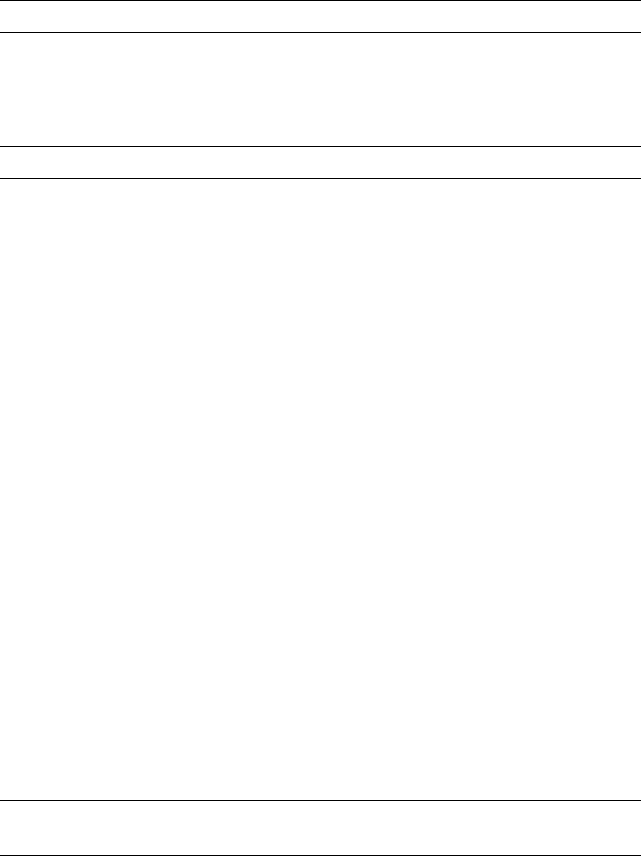
NOTE The spinner increments the field value by steps of 0.05.
+/- Increases/decreases each selected vertex's weight by 0.05.
Scale Weight Multiplies each selected vertex's weight value by the field value,
resulting in a relative weight change. Default=0.95.
NOTE The spinner increments the field value in steps of 0.05.
+/- Increases/decreases each selected vertex's weight by five percent.
Copy Stores the current weight value(s) in the copy buffer.
Paste Retrieves the weight values from the copy buffer and assigns them to
the selected vertices.
Paste-Pos Assigns the weight values currently in the copy buffer to the
selected vertices based on the distance between them and the copied vertices,
which is determined by the Paste-Pos Tolerance value.
This is useful when you need to match weights between two juxtaposed
skinned meshes sharing the a common bone.
Blend Modifies the selected weight values to smooth out the transition
between them and their surrounding vertices.
Paste-Pos Tolerance Determines the radius influence of the Paste-Pos.
Default=0.1.
Vertex information
Below the Paste-Pos Tolerance field is a text display displaying information
on the amount of copied and selected vertices.
[First Vertex Weight list] Displays the selected vertex weight along with the
bone envelopes contributing to its weighting. You can select individual
envelopes in the current viewport by highlighting the respective bone in the
list.
NOTE If you select multiple vertices, the list only displays the weighting of the
first selected vertex.
Weight Table (Skin Modifier)
Select an object that has the Skin modifier applied to it. > Modify panel > Skin
modifier > Weight Properties group > Weight Table
Skin Modifier | 1633
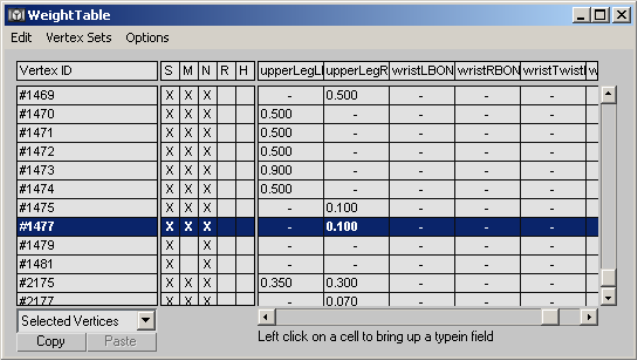
The weight table for the Skin modifier is used to change vertex weights for
several vertices and bones at a time. This table appears when you click the
Weight Table button.
Interface
Vertex numbers appear down the left column, while bone names appear across
the top. Vertex weights for each bone are displayed in the chart. You can
change vertex weights in a number of ways:
■Click and drag a vertex weight to the left or right.
■Highlight a weight and type in a new weight.
■Select vertices by dragging over vertex IDs, then click and drag one weight
to change all selected weights for the bone.
■Right-click to enter a value of 0.
■Ctrl+right-click to enter a value of 1.0.
Menu options:
Edit menu Copy/paste vertex weights, and choose vertices to edit.
■Copy: Copies weights for highlighted vertices.
■Paste: Pastes the copied weights.
1634 | Chapter 9 Modifiers

■Remove Zero Weights: All vertices with a weight less than the Remove
Zero Limit on page 1618 field value are stripped from their weight. Also
available on the Advanced Parameters rollout on page 1616 .
■Select All/None/Invert: Changes the selection of vertices.
Vertex Sets menu Select vertices in the left column by holding down Ctrl
while clicking vertices. Create a named selection set, which can then be picked
from the drop-down menu at the lower left of the dialog.
Options menu Customizes the weight table display.
■Flip UI: Flips the UI to show vertex IDs across the top and bone names
down the left side.
■Update On Mouse Up: When the mouse button is pressed down, no updates
will take place. When the mouse button is released, updates will occur.
This option helps keep workflow moving quickly by avoiding unnecessary
updates.
■Show Affected Bones: Displays only bones that affect the displayed vertices.
■Show Attributes: Toggles display of the S/M/N/R/H attributes.
■Show Exclusions: Toggles display of small check box areas in each vertex
weight field. Clicking the check box toggles exclusion of the vertex from
the bone (a red X appears in the check box when the exclusion is in effect).
■Show Global: Shows values for all displayed vertices.
■Show Set Sets UI: Displays info about vertex sets.
Dialog options
Vertex ID Vertices are displayed by number down the left column of the
weight table. Double-click a vertex number to cause the vertex to display in
pink in viewports. To display only selected vertices, choose Selected Vertices
from the drop-down menu at the bottom left of the dialog.
SIndicates vertex is selected.
MIndicates vertex weight has been modified.
Skin Modifier | 1635

NIndicates vertex weights are normalized (total of all vertex weights is
always 1.0).
RIndicates vertex is rigid (affected only by one bone, the one with the most
influence).
HIndicates patch handles are rigid (affected only by one bone, the one with
the most influence).
Vertex selection drop-down Choose to display all vertices, selected vertices
or only vertices affected by the selected bone.
Copy Copies weights for highlighted vertices.
Paste Pastes copied weights.
Skin Morph Modifier
The Skin Morph modifier lets you use a bone's rotation to drive a morph; that
is, a deformation of the object mesh. Skin Morph is intended for use with a
Skin or comparable modifier (e.g., Physique); add the Skin Morph modifier
after the skin-type modifier. You create the morph at the frame in which the
effect should be greatest, and then Skin Morph automatically animates the
affected vertices into and out of the morph, based on the rotation of the bone
that drives the morph.
This lets you fine-tune mesh deformation at any frame, using a bone to drive
the morph that is fixing a problem area. Typically, when animating a character
with bones, an artist has to create extra bones to handle problem areas such
as armpits and groin areas. With Skin Morph, instead of using extra bones,
you can simply create a morph, and then transform vertices into the exact
shape you want. Skin Morph lets you easily create muscle bulges and many
other effects.
NOTE When working with Skin Morph, it's important to be familiar with the
concept of delta . The frame at which you apply the modifier determines the base
position for each vertex that's used in a morphing animation controlled by Skin
Morph. After applying the modifier, go to a frame at which the bone driving the
morph is rotated an amount that will cause the greatest deformation, and then
transform vertices to produce the morph. The amount by which you transform
the vertices is called the delta : the difference between the base pose and the
morphed position.
1636 | Chapter 9 Modifiers
Procedures
To use Skin Morph (basic usage):
1Create an animated character with bones and a skinned body mesh, using
a modifier such as Skin on page 1600 or Physique on page 4054 .
2Go to the “pose frame” and apply the Skin Morph modifier.
The pose frame contains the initial pose; typically a standing character
with arms outstretched and legs apart. This is often frame 0, but it can
be any frame, even a negative-numbered one. This is the frame from
which the modifier measures delta: the change in the vertex position
between this pose and the morph.
3Determine which bones are driving deformations that you want to modify
with Skin Morph.
For example, bending an arm might cause the inside of the elbow to
indent too far, or you might want to add a bulging bicep. In this case,
the forearm bone is driving the deformation.
4Use Add to bind the deformation-driving bones to the modifier.
The modifier overlays an orange line along the length of each bone you
add.
5Go to the frame where you wish to create the morph. Using the
arm-bending example, this might be the frame where the forearm is at
a 90-degree angle to the upper arm.
6In the list box, click one of the bones.
In the viewport, the orange line representing the bone becomes a thicker
yellow line to indicate that this bone will drive the morph.
7On the Local Properties rollout, click Create Morph.
The modifier adds a morph to the highlighted bone and sets the morph
to 100% at this frame, as reflected by the number next to the morph's
name in the list.
8On the Local Properties rollout, click Edit.
This temporarily freezes the skin deformation at the current frame.
9Move vertices to where they should be at the current frame.
10 Click Edit again to exit this mode, and then test the animation.
Skin Morph Modifier | 1637
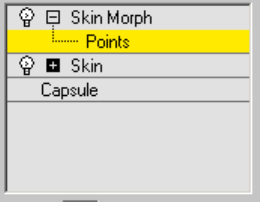
Interface
Skin Morph modifier stack
Points sub-object level At the Points sub-object level, you can view and select
vertices on the skin mesh. However, you can transform these vertices only
when Edit mode on page 1643 is on. The ability to select points when not in
Edit mode lets you make the selection when the points are more easily
accessible, and then go to the pose to transform them in Edit mode.
1638 | Chapter 9 Modifiers
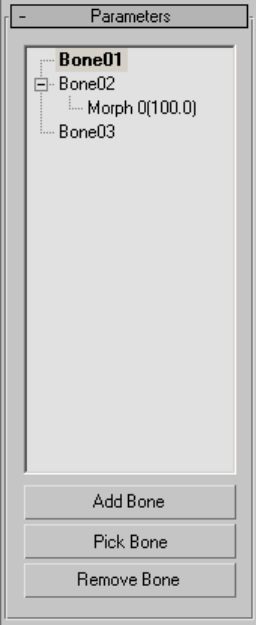
Parameters rollout
[list window] Lists all attached bones and their morphs in a hierarchical
view. You can expand or contract a bone's morph listing by clicking the + or
- box next to its name in the list. The number in parentheses next to the
morph name shows its relative influence as a percentage at the current frame.
Highlighting a bone in the list highlights the bone in the viewports as a yellow
line, and lets you create a morph for it. Alternatively, you can select the bone
in the viewport while the modifier's Points sub-object level is active by clicking
the orange line through its center.
Highlighting a morph in the list lets you edit the morph. To change the
morph's name, edit the Local Properties rollout > Morph Name field.
Add Bone Click to add one or more bones from the Select Bones dialog.
Skin Morph Modifier | 1639
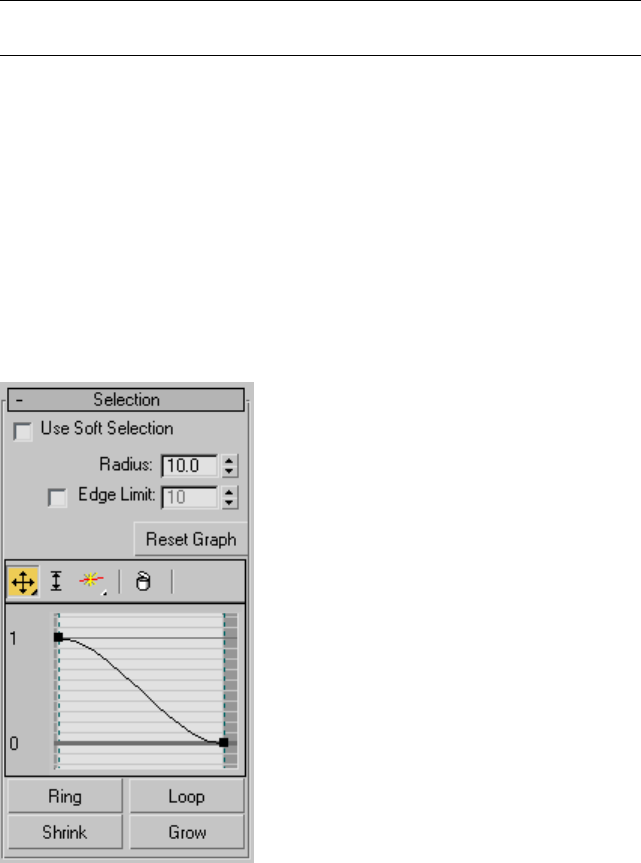
TIP To keep things simple, add only bones that will drive morphs. There's no point
in adding any other bones.
Pick Bone Lets you add bones by selecting them in a viewport.
Click Pick Bone, and then select bones in any viewport. While Pick Bone is
active, the cursor resembles a cross with the words ADD BONE attached. To
exit Pick Bone mode, right-click the active viewport or click Pick Bone again.
Remove Bone Removes a bone and its morphs from the list. Click a bone
name in the list, and then click Remove.
If a morph name is highlighted when you click Remove, its bone is removed.
To remove the morph only, highlight it and then click Local Properties rollout
> Delete Morph.
Selection rollout
Use Soft Selection Enables soft selection for editing vertices.
Soft Selection in Skin Morph works much like Soft Selection on page 1926 in
other parts of 3ds Max, except that instead of Pinch and Bubble settings you
can adjust the graph shape directly, and it uses a Radius setting instead of
Falloff to determine the extent of the soft-selection area.
1640 | Chapter 9 Modifiers
Radius Determines the extent of the soft-selection area in system units.
Edge Limit When on, Skin Morph uses the Edge Limit numeric setting to
determine the extent of the soft-selection area in terms of the number of edges
from the selected vertex or vertices.
Reset Graph Sets the soft-selection graph to default values. Use this if a vertex
or handle is no longer visible and thus cannot be manipulated.
[graph] Skin Morph provides a small, full-functioned curve graph for editing
soft-selection characteristics globally; it works much like other such graphs
in 3ds Max, such as Curve Editor on page 3441 . The toolbar above the graph
offers functions for moving and scaling points on the graph, as well as inserting
new ones. The same functions are available by right-clicking the graph: If you
right-click a graph point, you can set it to Corner or one of two different Bezier
types. If you select a Bezier point, you can reshape the curve by moving its
handles.
Ring Expands a vertex selection by first converting the selection to an edge
selection, selecting all edges parallel to the selected edges, and then converting
the new edge selection back to a vertex selection. Use of Ring requires that a
qualifying vertex selection exist; that is, at least two vertices on the same edge.
Loop Expands a vertex selection by first converting the selection to an edge
selection, selecting all aligned edges, and then converting the new edge
selection back to a vertex selection. Use of Loop requires that a qualifying
vertex selection exist; that is, at least two vertices on the same edge.
Shrink Reduces the vertex selection area by deselecting the outermost vertices.
If the selection size can no longer be reduced, the remaining vertices are
deselected.
Grow Expands the vertex selection area outward in all available directions.
Skin Morph Modifier | 1641
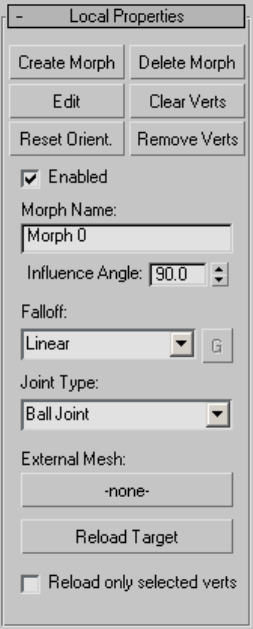
Local Properties rollout
This rollout contains functions for creating and editing individual morphs.
The settings, such as Morph Name and Influence Angle, are specific to each
morph.
Create Morph Sets a morph at the current frame for the highlighted bone.
Also sets the “pose” for this morph, using the bone's current orientation, and
sets the bone to 100%, as shown in the list window hierarchical view. When
you edit the morph, the skinned object returns to and stays at this orientation.
When you create a morph, the modifier displays, in orange, all vertices that
are part of the current pose (that is, they're offset from the initial pose). Also,
the modifier creates a default name for the morph and adds it as a child to
the highlighted bone in the list window.
1642 | Chapter 9 Modifiers

TIP By default, the Show Edges switch is on, which might make it difficult to see
the vertices themselves. To see only the vertices, turn off Options rollout > Show
Edges.
TIP To help keep track of morphs, use the Local Properties rollout to rename each
morph as you create it.
Delete Morph Deletes the highlighted morph, removing it from its parent
bone in the list window. Available only when a morph is highlighted.
Edit Lets you shape the current morph by transforming vertices. To exit Edit
mode, click the Edit button again.
Transforming a vertex in Edit mode creates a morph target. Each transformed
vertex moves into the morph target position (or orientation or scale) as the
morph value increases to 100.0, and then out of it as the morph value
decreases, based on the angle of the bone driving the morph.
Transforming a vertex in Edit mode also changes its color from orange to
yellow. This lets you easily see which vertices are part of the current morph.
Choosing Edit places the skinned object at the 100% “pose” orientation for
this morph (see Create Morph, above). It also activates the Points sub-object
level so you can transform vertices using the standard 3ds Max transform
tools.
Clear Verts Keeps selected vertices in the morph, but resets their deltas
(changes from the initial pose) to 0.
Reset Orient(ation) Sets the morph orientation to current orientation of the
bone that controls the morph.
This lets you change the angle at which the morph has its greatest effect. For
example, if you create a bulging bicep at frame 120, and later decide that the
muscle should be largest at frame 150 instead, go to frame 150, choose the
morph in the list box, and then click Reset Orientation.
Remove Verts Removes selected vertices from the current morph, which
deletes any animation applied as part of the morph.
Use this command to save memory by removing vertices not part of the morph
animation.
Enabled When on, the morph is active; when off, the morph doesn't appear
in the animation, and is indicated in the list box with the text “Disabled.”
Default=on.
Skin Morph Modifier | 1643
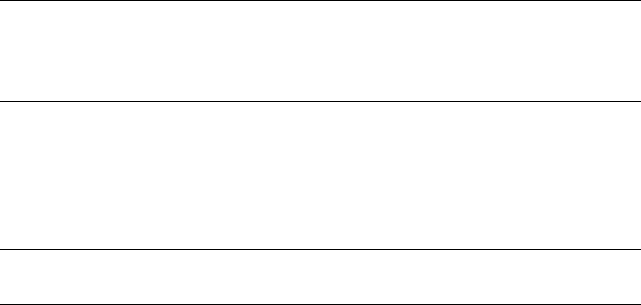
The ability to enable and disable each morph individually lets you isolate the
effect of each or test them in combination.
Morph Name Displays and lets you change the name of the current morph.
Influence Angle The angle around the bone's current orientation within
which the morph takes place. Default=90.0.
This is an important parameter. Think of the influence angle as a cone around
the bone at its orientation when you create the morph. Consider an example
in which Influence Angle is set to the default value of 90.0 degrees. If the bone
starts its rotation beyond 45 degrees away from the orientation at which the
morph was created, the morph has no effect at that time. As the bone moves
from 45 degrees away to the morph orientation, the morph increases to its
full value. As the bone then rotates away, the morph gradually decreases until,
at 45 degrees or more away from the morph orientation, the morph no longer
appears.
TIP Influence Angle is useful for isolating morphs; that is, to prevent overlapping
of different morphs on the same bone. Reduce the value until one morph's
contribution percent value (shown in the list box) falls off to 0.0 before the next
one begins.
Falloff Determines the rate of change of the morph as the bone moves within
the influence angle. Use the drop-down list to choose one of four different
falloff types: Linear, Sinual, Fast, or Slow. If you choose Custom Falloff, you
can then click the G (for Graph) button and edit the falloff using standard
curve-graph controls.
NOTE The default graph, displayed when you first access the falloff graph, shows
the Sinual falloff type.
Joint Type Determines how the modifier tracks the angular motion of the
bone. This is a per-bone setting, not per-morph. Default=Ball Joint.
■Ball Joint Tracks all rotation of the bone. Use this setting in most cases.
■Planar Joint Tracks rotation of the bone only in the plane of its parent
bone.
External Mesh Lets you use a different mesh as a morph target. Click the
button (default label=-none-) and then select the target object. The target
object should have the same mesh structure as the Skin Morph object. After
specifying an external mesh, its name appears on the button.
1644 | Chapter 9 Modifiers
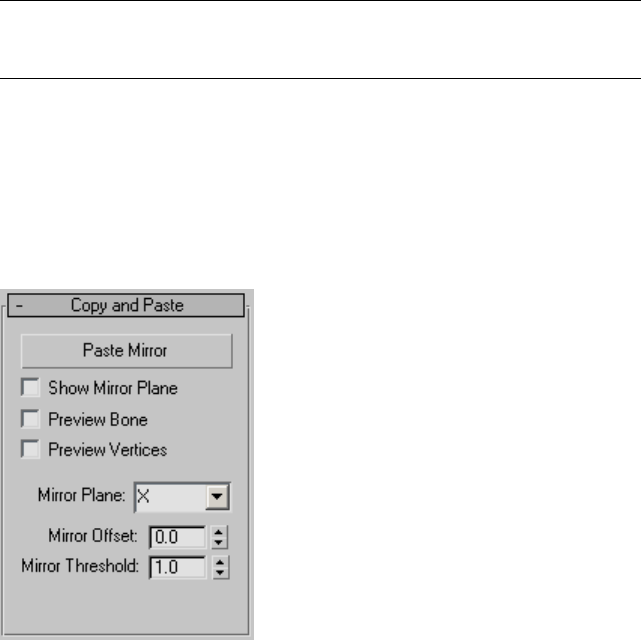
Using an external mesh makes it easier to set up morph targets in a target
mesh that uses a reference pose, rather than the skinned, animated mesh of
which sections might be interpenetrating, making it difficult to select the
specific vertices to be morphed. In this situation, it's probably best to turn
Reload Only Selected Verts.
NOTE The external-mesh connection is not live; if you edit vertices in the external
mesh, Skin Morph doesn't automatically recognize the changes. To update the
vertex positions after editing the external mesh, use Reload Target (see following).
Reload Target Updates the Skin Morph object with edited vertex positions
from the external mesh.
Reload only selected verts When on, Reload Target copies only the positions
of vertices selected in the Skin Morph mesh from the target mesh. When off,
Reload Target copies the positions of all vertices. Default=off.
Copy and Paste rollout
These functions let you copy all morph targets for a specific bone from one
side of the object to the other. Indicate the morphs to copy by highlighting
the bone or any of its morphs in the Parameters rollout > list box.
Paste Mirror Copies the morphs from the highlighted bone to the target on
the other side of the mirror gizmo. A qualified target bone must exist and be
present in the list box.
Skin Morph Modifier | 1645

NOTE This copies the morph data only; the rotation of the target bone must be
comparable to that of the source bone for the morphing to appear in the
animation.
Show Mirror Plane Displays the mirror plane as a red, rectangular gizmo in
the viewports. The target bone must be on the opposite side of the mirror
plane from the highlighted bone, and must be present in the Parameters
rollout > list box.
Preview Bone Highlights the target bone in red in the viewports.
Preview Vertices Displays the morphing-qualified vertices in red in the
viewports, as well as any animation present in the source vertices.
Mirror Plane The axis for the mirror plane. The plane is perpendicular to
the indicated axis. Default=X.
Mirror Offset The position for the mirror plane on the Mirror Plane axis.
Default=0.0.
Mirror Threshold The radius, in system units, within which Skin Morph
looks for a qualifying target bone on the other side of the mirror plane.
Default=1.0.
1646 | Chapter 9 Modifiers
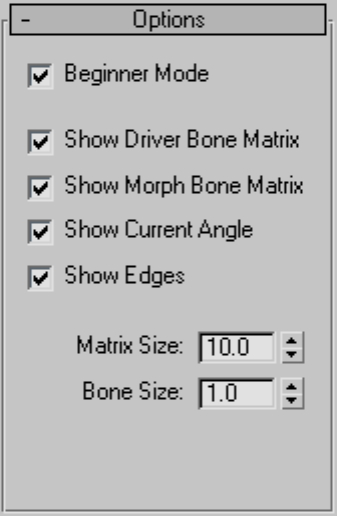
Options rollout
Beginner Mode When on, you must use the Create Morph button to create
a morph and the Edit button to edit a morph.
When off, you can create and edit morphs on the fly. In this mode, when you
select and move vertices at the Points sub-object level, the software first
determines whether a morph exists for the selected bone at 100%; if so, all
edits will go to that morph. Otherwise, the software creates a new morph
automatically and applies the edits to that morph.
Show Driver Bone Matrix Shows the matrix tripod of the current bone.
Show Morph Bone Matrix Shows the tripod of the orientation of the active
morph.
Show Current Angle Shows pie wedges depicting the angles between the
driver bone matrix and the morph bone matrix. These are color coded: red
for the angle about the X axis; blue for the angle about the Y axis; and green
for the angle about the Z axis.
Show Edges Highlights the edges connected to morphable vertices in orange.
Skin Morph Modifier | 1647
This is useful when a tessellating modifier such as MeshSmooth is applied to
the skinned mesh above the Skin Morph modifier, to see the actual mesh
being affected by Skin Morph.
Matrix Size The size of each tripod.
Bone Size The size of the bone display.
Skin Wrap Modifier
Make a selection. > Modify panel > Modifier List > Object-Space Modifiers >
Skin Wrap
The Skin Wrap modifier allows one or more objects to deform another. While
Skin Wrap is flexible enough to serve a variety of needs, it's primarily intended
for animating a high-resolution object, such as a character mesh, with a
low-resolution one.
The low-resolution object doing the deforming is called a control object, and
the high-resolution object it's affecting (that is, the one with the Skin Wrap
modifier) is the base object. A base object can be any type of deformable object.
Also, in this topic, control vertex refers to a vertex on the control object, and
point refers to a vertex on the base object.
With Skin Wrap, you can modify the structure and topology of the
high-resolution object after setting up the animation. The animation remains
intact because it is actually contained in the control object.
In most cases, when using Skin Wrap, the control object is positioned near
the modified base object, and then bound to the latter using the modifier's
Add function. By default, moving a vertex in the control object affects nearby
vertices in the base object. Additional options allow faces in the control object
to affect the nearest points in the base object instead (Blend To Base Object).
Conversely, points in the control object can affect faces in the base object
(Face Deformation).
Skin Wrap offers a great deal of control in that you can set a different strength
value for each control vertex, as well as the shape of its volume of influence.
You can also convert the Skin Wrap effect to a Skin modifier applied to the
high-res model, suitable for use with game engines. And the ability to animate
with multiple control objects lets a technical director assign animation of
different parts of a complex character mesh to various artists.
1648 | Chapter 9 Modifiers

TIP If you use a control object to which non-uniform scaling has been applied,
its vertices will have non-spherical volumes of influence, which can lead to
unexpected results. In such a case, before adding the control object to the modifier,
apply Reset XForm on page 886 and then collapse the stack.
See also:
■Skin Wrap Patch Modifier on page 1657
Procedures
To use Skin Wrap (basic method):
1Create a high-resolution base object and one or more low-resolution
control objects, which will deform the base object. In general, each control
object should have an overall shape similar to the part of the base object
that it will deform, and be positioned near that part of the base object.
2Apply Skin Wrap to the high-resolution base object. The modifier transfers
animation or modeling from the control object to the base object.
3On the Skin Wrap > Parameters rollout, use Add to assign the control
object(s).
4Choose a deformation engine: Vertex or Face.
5Set global parameters as desired. These parameters affect all control
vertices, and include Deformation Engine, Falloff, Distance Influence,
and Face Limit.
6To set local parameters, including strength and influence distances, access
the Control Vertices sub-object level of the Skin Wrap. Select one or more
control vertices, and then change the settings as necessary.
7Edit or animate the control object with modifiers and/or sub-object
transforms; the high-resolution (base) object deforms accordingly.
8Repeat steps 5, 6, and 7 as necessary. Occasionally you might need to
reset the modifier as well, by clicking the Reset button. Before doing so,
always return to a non-deformed point (or “skin pose”) in the animation;
typically, frame 0.
Skin Wrap Modifier | 1649
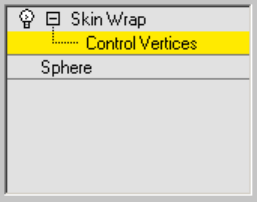
Interface
Skin Wrap modifier stack
Control Vertices sub-object level At the Control Vertices sub-object level,
you can view and select vertices on the control object(s), and set local
parameters on page 1653 for any selected vertices. By default, each selected
vertex is surrounded by loops on page 1656 that depict its volume of influence.
This sub-object level also uses color coding on affected points in the base
object to show each selected vertex's relative effect on points within the volume
of influence. Colors range from orange for the strongest influence to blue for
the weakest influence. Red is for vertices that are within its range of influence
but that it's not influencing.
By default, at this level, control vertices appear as small orange squares. To
prevent this, turn off Display Parameters rollout > Display Control Vertices.
1650 | Chapter 9 Modifiers

Parameters rollout
[control object list] Lists object(s) that deform the modified object. Use the
Add and Remove functions to edit the list contents.
Skin Wrap Modifier | 1651
Add Adds control objects to the list. Click Add, and then click each control
object in turn. To stop adding, right-click in the viewport or click Add again.
You can use as a control object anything that can be converted to a triangle
mesh, such as a mesh, patch, or a NURBS object. However, avoid using objects
that change topology, such as a deforming NURBS object with adaptive
tessellation.
Remove Removes control objects from the list. Click an object in the list,
and then click Remove.
Deformation Engine Determines which engine drives the deformation.
Default=Vertex Deformation.
■The Vertex Deformation engine is a weighted engine; it uses vertex
proximity to drive the deformation. That is, each vertex in the control
object affects nearby points in the high-resolution (base) mesh.
■With the Face Deformation engine, each control vertex is tied to the closest
face in the base object. Face deformation can use falloff, or be a rigid
deformation by setting Falloff to 0.001, the lowest possible value.
Falloff Determines the extent to which the control vertices affect nearby
points in the base object. This is a global setting. Default=1.0. Range=0.001
to 10.0.
Higher values pull nearby points closer to the control vertex. In Face
Deformation mode, setting Falloff to the lowest value, 0.001, causes rigid
deformation so that there's no falloff; the control vertex either affects the
base-object face or it doesn't. For best results, use Falloff values between 1.0
and 2.0, or with Face Deformation, 0.001 for rigid mode.
Distance Infl(uence) Determines the distance of influence, in system units,
of control vertices in the control object. This is a global setting, and is available
only in Vertex Deformation mode. Default=1.2. Range=0.001 to 10.0.
Distance Influence is a multiplier. It looks at the length of each edge that
touches each control vertex. For each vertex, it averages all the lengths and
then multiplies the average by the Distance Influence value. This lets vertices
that are touching only small faces to affect a small area, and vice-versa. The
higher the influence value, the smoother the deformation, but the less
individual control each vertex has. For best results, keep this value between
1.0 and 2.0.
Face Limit Determines the extent of influence, in control-object faces, of
control vertices in the control object. This is a global setting, and is available
only in Vertex Deformation mode. Default=3. Range=0 to 10.
1652 | Chapter 9 Modifiers
Beyond this limit, no base-object points can be influenced by the control
vertex, even if they're within the Distance Influence radius.
Face Limit is useful for preventing the control-object influence from bridging
gaps in the mesh; for example, between fingers in a character mesh.
Blend To Base Mesh Causes the modifier to base deformation on the distance
from each affected point to the closest face in the control object. Turning on
this option makes the Blend Distance setting available.
Blend Distance Determines the relative distance between control-object faces
and vertices in the base object for deformation to take effect. Available only
when Blend To Base Mesh is on. Default=5.0.
Increasing this setting effectively causes a stronger deformation effect and
broadens the area on the control that affects the base object.
[local parameters]
The Local parameters are available only at the Control Vertices sub-object
level (see Skin Wrap modifier stack on page 1650 ), and affect only selected
points. If you select a single point, the numeric fields reflect its current
parameter values. If you select multiple points, 3ds Max displays only those
values common to all selected points; parameters with differing values are
blank. With multiple points selected, changing a value sets all selected points
to that value.
Local Str(ength) Determines the power and direction by which the
control-object vertex affect points under its influence in the base object. A
positive value pulls the points toward the vertex; a negative value pushes them
away. Default=1.0.
Local Scale Mult(iplier) Scales each selected control-object vertex's volume
of influence uniformly. Default=1.0.
Use the scale settings to increase or decrease the area of the base object that
the selected control vertex affects.
Local X/Y/Z Scales each selected control-object vertex's volume of influence
along the indicated axis. Default=1.0.
Change these parameters to produce a non-spherical volume of influence.
Reset Resets all control-object vertices' local values to 1.0 and resamples the
mesh. It recalculates the control vertices' influence on the base object using
the current modifier settings.
Skin Wrap Modifier | 1653
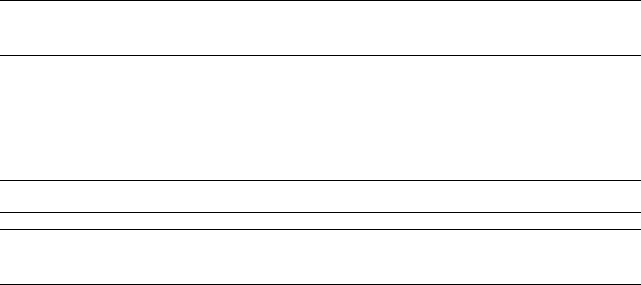
Use Reset if you alter a parameter but don't see any change in the deformation.
For example, always use Reset after changing the Threshold value. Or, if you
want the control object to affect a different part of the base object, move the
former, and then use Reset so the modifier accounts for the change in
positional relationship between the two. You might also need to reset after
changing the topology of the base object or a control object.
IMPORTANT Use Reset at a point in the animation where no deformation is in
effect; typically, frame 0.
Threshold Determines the distance in system units that the software uses
to find the closest face to a control vertex. The greater the distances by which
the control object's and base object's surfaces deviate, the higher the Threshold
value needs to be. Default=5.0.
NOTE Threshold is recomputed only when you add a base mesh or click Reset.
WARNING Be careful about increasing this setting. High values can result in
excessive computation times, especially with complex base objects.
Weight All Points Forces all base-object points to have weights. Each weight
is calculated from a combination of three factors: control vertex scale, control
vertex strength, and base-object point position.
By default, not all base-object points are necessarily influenced by the control
object. Turning on Weight All Vertices causes all points to be influenced by
one or more control vertices. If a large number of base-object points are
unassigned, this can take a long time to calculate.
Convert To Skin Applies a new Skin modifier on page 1600 to the base object
that replicates the animation in the Skin Wrap modifier. Using this function
requires that a Skin modifier already be applied to each control object.
Basically, Convert To Skin intelligently “bakes” the animation from skinned
low-res control objects to the high-res base object. The Skin modifier that it
creates contains all the bone assignments from the original Skin modifier, but
with completely rebuilt weight settings based on the base-object weights
created by the Skin Wrap modifier.
This function is useful in game-development settings where the game engine
recognizes the Skin modifier settings but not the Skin Wrap modifier.
1654 | Chapter 9 Modifiers
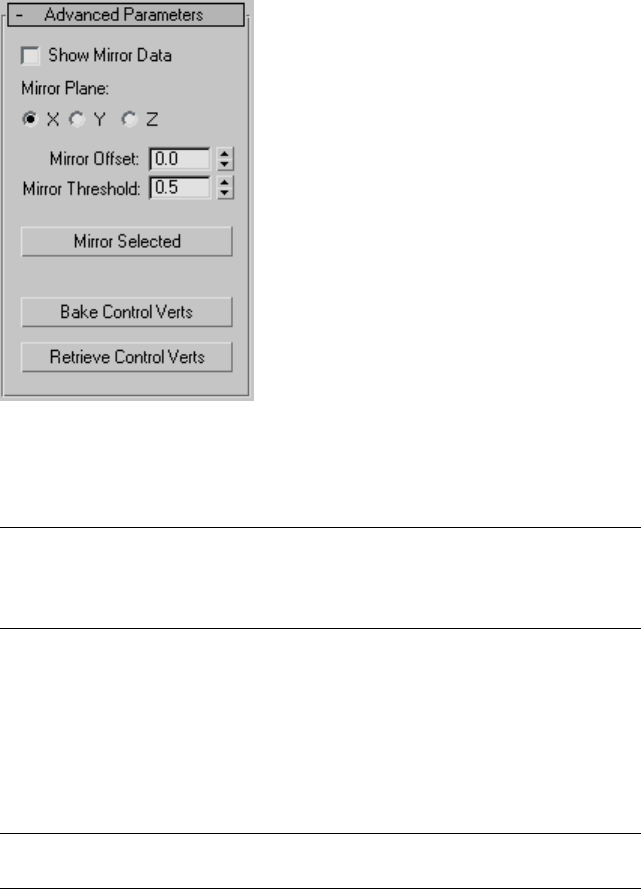
Advanced Parameters rollout
The Mirror tools in Skin Wrap let you apply local settings (Strength and Scale)
from control vertices on one side of a control object to the other, mirroring
them across a plane aligned with the X, Y, or Z axis. This is useful for setting
up character meshes.
NOTE Mirror copies only Skin Wrap settings from control vertices; it doesn't copy
animation data. Thus, when using Skin Wrap with a character model, first make
local settings for control vertices on one side of the control object, select the
vertices to copy, mirror them, and then animate the control object.
The Bake/Retrieve Control Vertices functions let you store control-vertex
settings into the base object and then retrieve them. This is useful for sharing
data among artists working on the same project.
Show Mirror Data Turns on display of the mirror plane gizmo as well as a
small circle showing the projected location for each selected control vertex.
Move the gizmo and the projected locations with the Mirror Offset control
(see following).
NOTE For mirror data to be visible, the Skin Wrap > Control Vertices sub-object
level must be active.
Mirror Plane Choose the X, Y, or Z axis for mirroring.
Mirror Offset Moves the mirror plane as well as all mirrored vertices.
Skin Wrap Modifier | 1655
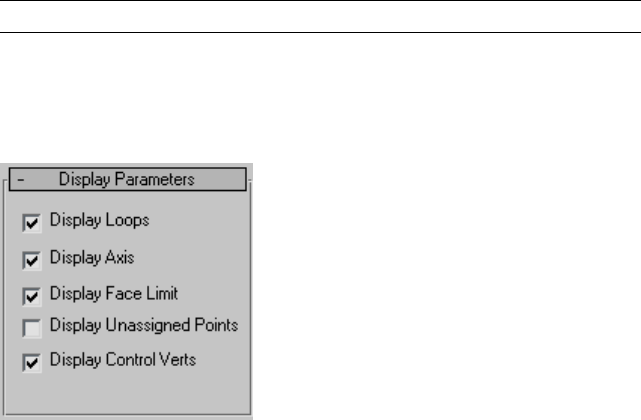
Mirror Threshold Sets the distance, in system units, that Skin Wrap uses to
find a control vertex near a projected vertex. Increase this if vertex locations
are not the same on either side of the mirror plane.
Mirror Selected Copies the local settings from each selected control vertex
to any control vertices within the threshold distance of its projected location
on the other side of the mirror plane.
Bake Control Verts Stores the Local Strength/Scale and the global Falloff,
Distance Infl., and Face Limit settings on the control objects for later retrieval
with Retrieve Control Vertices.
NOTE This data is static; any changes to the base-object topology invalidates it.
Retrieve Control Verts Takes any control-vertex data stored on the control
objects with Bake Control Vertices and copies them into the modifier.
Display Parameters rollout
These settings determine whether or not the software displays different
elements in the Skin Wrap modifier.
Display Loops Displays volumes of influence for selected control vertices as
red loops. Default=on.
Display Axis Displays the axis tripods for selected control vertices. Default=on.
Display Face Limit Shows all base-object points that the selected control
vertex or vertices can affect. This is a visualization of the Face Limit setting
on page 1652 . Default=on.
Display Unassigned Points Draws a red circle around each base-object point
that the system did not find a closest face for and draws a red box around
1656 | Chapter 9 Modifiers
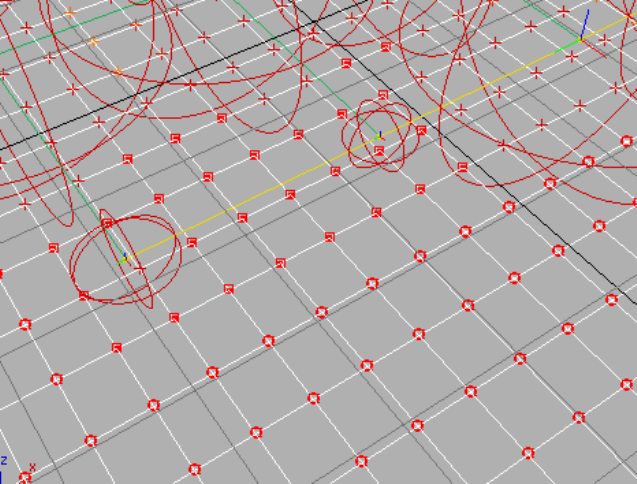
each point that has a closest face but is not weighted by any control vertex.
Default=off.
Unassigned points: The circled points (bottom) have no closest face, while the points
with red boxes (center) have a closest face but aren't weighted by control vertices.
This is an important debugging tool because any vertex that is not assigned
a closest face will never be weighted. To do so, you need to increase the
Threshold value and click Reset, or turn on Weight All Points. Any points that
are not weighted to a control vertex can be fixed by increasing the Local Scale
of a control vertex near that point.
Display Control Verts Toggles display of all control vertices. Default=on.
Skin Wrap Patch Modifier
Make a selection. > Modify panel > Modifier List > Object-Space Modifiers >
Skin Wrap Patch
Skin Wrap Patch is a simple modifier that allows a patch object to deform a
mesh object. It's very easy to use: just assign the modifier to a mesh object,
and then use the modifier to specify a deforming patch object. Each point on
Skin Wrap Patch Modifier | 1657
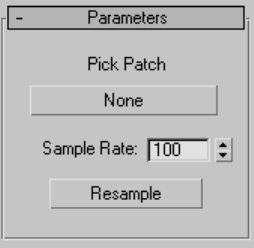
the patch object influences a surrounding volume of points on the mesh
object.
See also:
■Skin Wrap Modifier on page 1648
Interface
Pick Patch Click this button, labeled “None” by default, and then select a
patch object to deform the mesh object. After picking the patch object, its
name appears on the button.
Sample Rate Determines the accuracy with which the modifier samples the
patch object. The higher the rate, the more accurate the resulting animation
will be, but the longer it will take to calculate.
Resample Forces the system to resample the date. This should be done at a
point in the animation at which no deformation takes place; typically, frame
0.
Slice Modifier
Select an object. > Modify panel > Modifier List > Object-Space Modifiers >
Slice
Select an object. > Modifiers menu > Parametric Deformers > Slice
The Slice modifier lets you create a cutting plane that slices through a mesh,
creating new vertices, edges and faces based on the location of the slice plane
gizmo. The vertices can either refine or split the mesh according to the selected
options.
1658 | Chapter 9 Modifiers
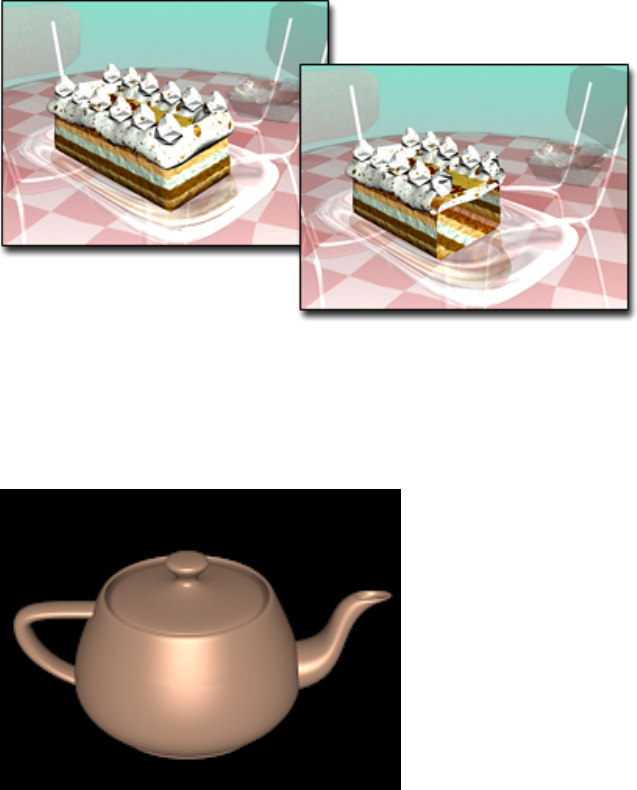
The Slice modifier slices through groups, selected objects or sub-object
selections of faces. It works similarly to the Editable mesh > Edge > Slice
function but does not require the objects to be editable meshes.
Slice cuts through the cake.
You can animate the cutting plane, changing its position and rotation over
time. You can also use the Remove Top and Remove Bottom options to create
the appearance and disappearance of objects by animating the Slice Plane
gizmo.
Slice Modifier | 1659
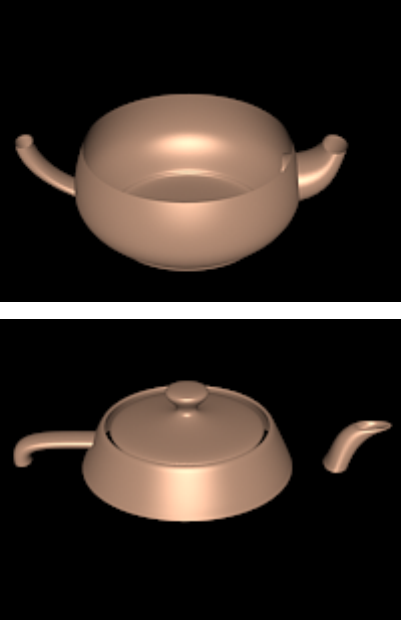
Top: Original object
Middle: Object without top
Bottom: Object without bottom, respectively
Multiple Slices
To create multiple slices in an object you need to apply multiple Slice modifiers.
If the geometry doesn't need to remain parametric, you can collapse it into
an editable mesh and use the Slice tool available under Editable Mesh (Edge)
on page 2007 . This tool is easier to use when you need to make multiple slices
in an object, but it does not stay parametric.
1660 | Chapter 9 Modifiers
Warning: Slice and Sub-Object Selections
You can use Slice on sub-object selection sets by slicing or removing only the
selected faces. However, because selected faces are sliced and unselected
adjacent faces are not, there may be "holes" in the mesh on the edge where
the slice occurs. These holes can be problematic, creating discontinuities in
smoothing and rendering. Holes are created only when Operate On Faces is
on.
Procedures
Example: To animate the appearance of a teapot using the Slice modifier:
1Create a teapot on page 377 primitive. Set the viewport to wireframe.
2Apply a Slice modifier.
The Slice Plane gizmo appears at the base of the teapot.
3On the stack display, choose the Slice Plane gizmo.
4Turn on the Auto Key button, and move the time slider to frame 100.
5Move the Slice Plane gizmo above the top of the teapot. Play the
animation to verify that the slice plane is animated.
6Change the Slice type from Refine Mesh (the default) to Remove Top.
Play the animation again.
7Make a copy of the teapot in the same position (choose Edit menu >
Clone and click OK to accept the default settings).
8Put a Wireframe material on the clone and change the Slice type on the
clone to Remove Bottom.
9Play the animation.
The wireframe teapot magically becomes a fully shaded one.
Slice Modifier | 1661
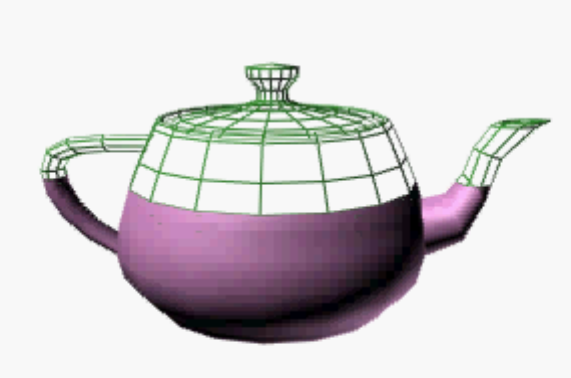
Example: To slice vertically through an object:
1Create a teapot on page 377 primitive.
2Apply a Slice modifier.
The Slice Plane gizmo appears at the base of the teapot.
3On the stack display, open the Slice modifier and choose the Slice Plane
gizmo.
4Move the Slice Plane gizmo so it intersects the middle of the teapot.
5Rotate the Slice Plane gizmo so it is vertical.
6Turn on Remove Top.
The back of the teapot is sliced away.
7Turn on Remove Bottom.
The front half of the teapot is sliced away.
1662 | Chapter 9 Modifiers
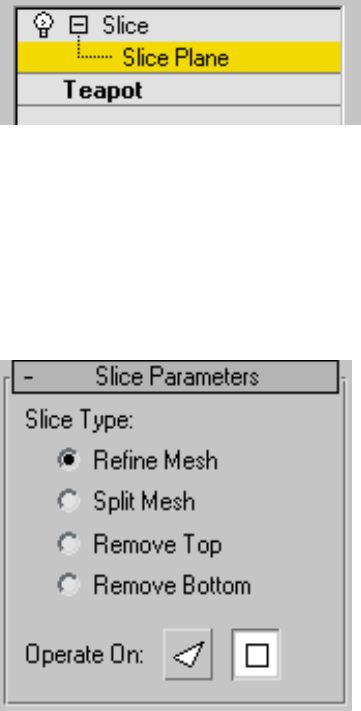
Interface
Modifier Stack
Slice Plane At this sub-object level, you can transform and animate the gizmo
like any other object to determine where the slice occurs. Scaling the gizmo
has no effect, because its extents are effectively infinite. If you need to limit
the extent of the slice, use it on a sub-object selection set of faces, rather than
on the entire object.
For more information on the stack display, see Modifier Stack on page 7427 .
Slice Parameters rollout
Slice Type Defines how the slice plane will affect the geometry to which it
has been applied.
■Refine Mesh Adds new vertices and edges along the intersection of the
geometry with the slicing plane. Faces cut by the plane are subdivided into
new faces.
Slice Modifier | 1663
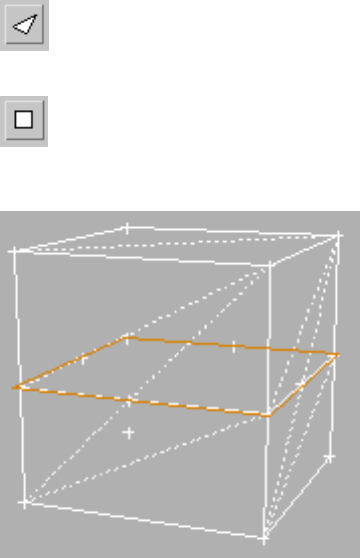
■Split Mesh Adds a double set of vertices and edges along the plane
boundary producing two separate meshes (one on either side of the slice
plane), which you can modify differently if desired. Use this to break a
mesh in two.
■Remove Top Deletes all the faces and vertices above the Slice Plane.
■Remove Bottom Deletes all the faces and vertices below the Slice Plane.
Operate On Choose one of these buttons to specify how the slice handles
quads and other polygons.
■Faces Treats the selection set as a set of triangular faces, slicing
each one in turn. Outputs a mesh-type object on page 1990 .
■Polygons Converts the object to a polygon mesh based on visible
edges, eliminating hidden edges. Outputs a polymesh-type object on page
2038 .
1664 | Chapter 9 Modifiers
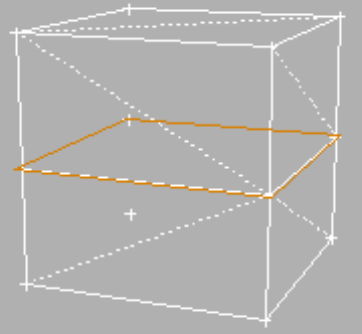
Operate On Face vs. Operate On Polygon
Smooth Modifier
Select an object. > Modify panel > Modifier List > Object-Space Modifiers >
Smooth
Select an object. > Modifiers menu > Mesh Editing > Smooth
The Smooth modifier provides auto-smoothing based on the angle of adjacent
faces. You can apply new smoothing groups to objects.
Smoothing eliminates the facets on geometry by grouping faces into smoothing
groups. At render time, faces in the same smoothing group appear as a smooth
surface.
Smooth Modifier | 1665
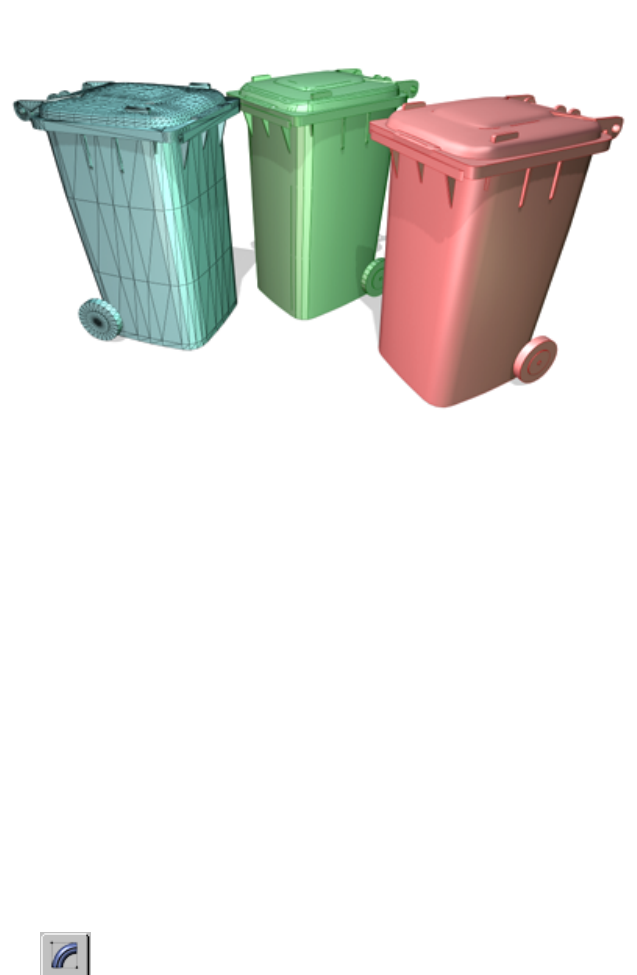
Curved surfaces gradually smoothed:
Left: No smoothing
Center: Smoothing but some edges on the corners
Right: Full smoothing
Patches
As of 3ds Max 4, patch objects coming up the modifier stack are not converted
to a mesh by this modifier. A patch object input to the Material modifier
retains its patch definition. Files that contain patch objects with the Material
modifier from previous versions of the software will be converted to meshes
to maintain backward compatibility.
Procedures
To smooth an object:
1Select the object to be smoothed.
2 On the Modifiers menu, choose Mesh Editing > Smooth.
1666 | Chapter 9 Modifiers
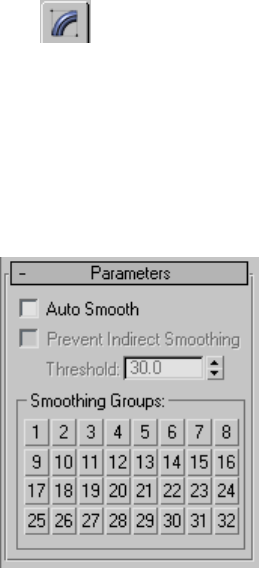
3On the Modify panel, choose Object-Space Modifiers > Smooth from the
Modifier List.
4Turn on Auto Smooth and adjust the Threshold for the desired smoothing
effect.
To apply smoothing groups manually:
1Select an object.
2 Use a Mesh Select modifier on page 1455 to select the faces to be
smoothed.
3Click a numbered button to apply the corresponding smoothing group
to the selected faces.
Interface
Parameters rollout
Auto Smooth If Auto Smooth is selected, the object is auto-smoothed using
the (animatable) threshold specified by the Threshold setting below it. Auto
Smooth sets the smoothing groups based on the angle between faces. Any two
adjacent faces are put in the same smoothing group if the angle between their
normals is less than the threshold angle.
Prevent Indirect Smoothing Turn on to prevent smoothing 'leaks" when
using Auto Smooth. If you apply Auto Smooth to an object, and portions of
Smooth Modifier | 1667

that object that should not be smoothed become smoothed, then turn on
Prevent Indirect Smoothing to see if it corrects the problem.
NOTE This option has an effect only when Auto Smooth is selected. The problem
it corrects is rare, and turning on Prevent Indirect Smoothing slows the Auto
Smooth process. Don't use this option unless you see something wrong with your
existing smoothing.
Threshold Specifies the threshold angle in degrees. Any two adjacent faces
are put in the same smoothing group if the angle between their normals is
less than the threshold angle.
Smoothing Groups group
The grid of 32 buttons shows which smoothing groups are used by the selected
faces, and are used to assign smoothing groups manually to selected faces.
Spherify Modifier
Select an object. > Modify panel > Modifier List > Object–Space Modifiers >
Spherify
Select an object. > Modifiers menu > Parametric Deformers > Spherify
The Spherify modifier distorts an object into a spherical shape. This modifier
has only one parameter: a Percent spinner that deforms the object, as much
as possible, into a spherical shape.
1668 | Chapter 9 Modifiers
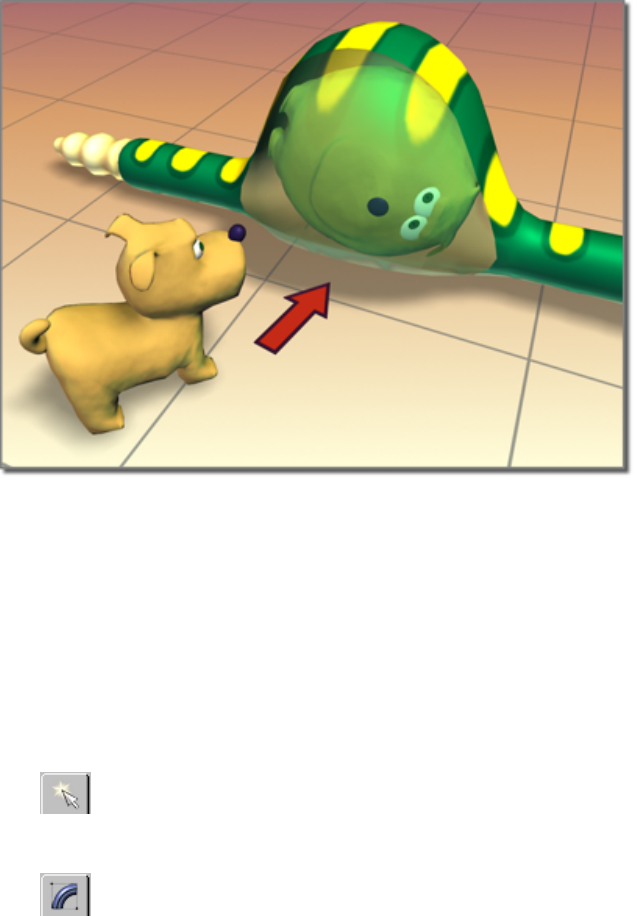
Spherify shapes the dog inside the snake.
The success of the operation depends on the topology of the geometry to
which it's applied. For example, a cylinder with no height segments will result
in little change. Adding height segments will result in a barrel at 100 percent.
Adding cap segments will produce a sphere.
Try this on a teapot on page 377 .
Procedures
Example: To use the spherify modifier to distort a teapot:
1Click Create > Geometry > Standard Primitives > Teapot.
2Create a teapot in the viewports.
3On the Modify panel, choose Spherify from the Modifier List.
The teapot should now look like a sphere.
4Adjust the Percent setting to less than 100%.
Spherify Modifier | 1669
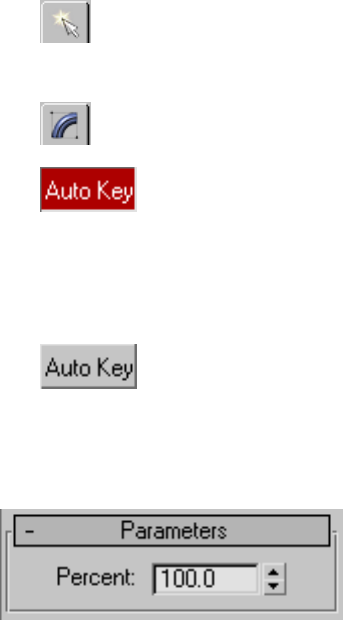
Example: To animate spherifying a teapot:
1 Click Create >Geometry > Standard Primitives > Teapot.
2Create a teapot in the viewports.
3 On the Modify panel, choose Spherify from the Modifier List.
4 Turn the Auto Key button on.
5Set the Spherify Percent to 0.
6Move the time slider ahead to frame 30.
7Set the Spherify Percent to 100.
8 Turn the Auto Key button off.
9Drag the time slider to play the animation, or click Play.
Interface
Percent Sets the percentage of spherical distortion to apply to an object.
Spline IK Control Modifier
Select a spline or NURBS curve > Modify panel > Modifier List > Spline IK
Control
When the Spline IK Control modifier is applied to a spline, you can select and
transform its vertices without having to access the vertex sub-object level. It
can also place helpers at each vertex location to aid in moving vertices.
1670 | Chapter 9 Modifiers
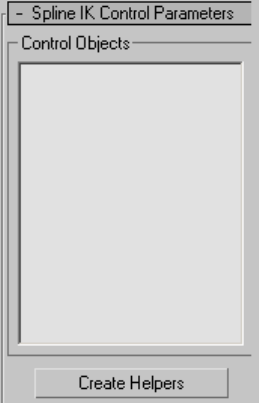
The Spline IK Control modifier works by placing knots (control points) at each
vertex. The knots can then be used to control vertices, which in turn reshape
the spline.
This modifier also works on NURBS curves, placing a knot at each control
point or control vertex (CV).
Use the Spline IK Control modifier to prepare a spline or NURBS curve for use
with the Spline IK Solver.
See also:
■Spline IK on page 3369
Interface
Control Objects When helpers are created, knot numbers and their
corresponding names appear here. Knot #1 is placed at the first vertex on
page 7785 on the spline, and additional knots are numbered in sequence.
Create Helpers Places a helper at each knot, and displays knot numbers and
helper names in the Control Objects area. Helper display is based on selections
in the Helper Display group. Helpers are linked upon creation if a linking
option is selected in the Link Types group.
Spline IK Control Modifier | 1671
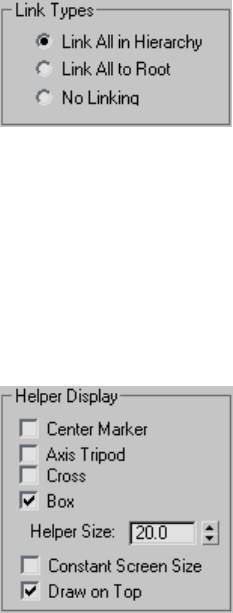
Link Types group
These options cause helpers to be linked upon creation.
Link All in Hierarchy Links each helper to its immediately previous helper.
For example, the helper at knot #3 is linked to the helper at knot #2, while
the helper at knot #2 is linked to the helper at knot #1.
Link All to Root Links each helper to the helper at knot #1.
No Linking Helpers are not linked.
Helper Display
When you click Create Helpers, the software can place one or more Point
helper objects at each knot, making it easier to move and animate the knots.
You can enable more than one type of helper.
Center Marker Places a small X-shaped Point helper at each knot.
Axis Tripod Places a small tripod-axis-shaped Point helper at each knot.
Cross Places a small cross-shaped Point helper at each knot.
Box Places a small box-shaped Point helper at each knot.
Size Sets the size for helpers.
Constant Screen Size Keeps the sizes of helpers constant regardless of the
zoom extent of the viewports.
1672 | Chapter 9 Modifiers
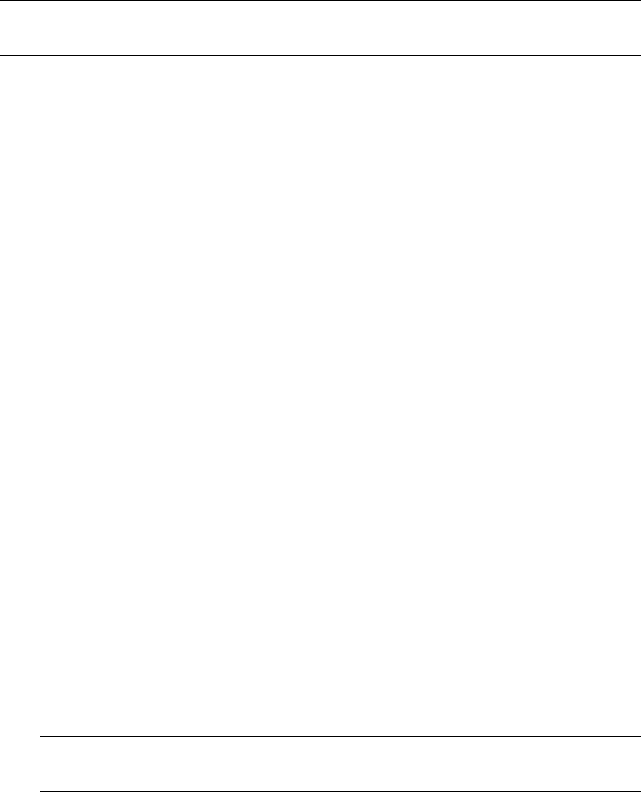
Draw On Top Displays the helpers on top of all other objects in the scene
for improved visibility in busy scenes.
TIP To change the display of helpers after creation, select each helper and change
selections on the Modify panel.
Spline Select Modifier
Select a shape. > Modify panel > Modifier List > Object–Space Modifiers >
Spline Select
Select a shape. > Modifiers menu > Selection Modifiers > Spline Select
The Spline Select modifier passes a sub-object selection of shapes up the stack
to subsequent modifiers. It provides much of the same set of selection functions
available in the Edit Spline modifier on page 1376 . You can select vertices,
segments, or splines, and you can change the selection from sub-object level
to object level.
This modifier is similar to the Mesh Select on page 1455 and Poly Select
modifiers on page 1541 , except for the type of sub-object components.
Procedures
To use the Spline Select modifier:
1Create a multi-spline shape.
2Apply a Spline Select modifier.
By default, the Vertex sub-object level is active.
3If you wish to work at a different sub-object level, use the modifier stack
display to choose it.
4In the viewports, select vertices, segments, or splines.
TIP You can transform the selection using an XForm modifier on page 1922
or Linked XForm modifier on page 1440 .
Spline Select Modifier | 1673

Interface
Modifier Stack
The sub-object level you choose for the spline select modifier determines
which rollout appears. (There are no parameters at the top, object level.)
Vertex Creates a sub-object selection of vertices.
Segment Creates a sub-object selection of segments.
Spline Creates a sub-object selection of splines.
For more information on the stack display, see Modifier Stack on page 7427 .
Select Vertex rollout
Get Segment Selection, Get Spline Selection Select vertices based on the
last Segment or Spline selection. This selection is added to the current selection.
Available only when Vertex is not the current sub-object level.
1674 | Chapter 9 Modifiers
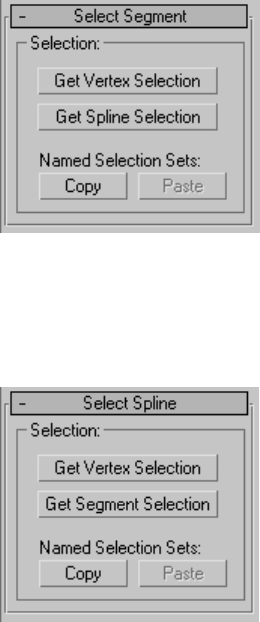
Select Segment rollout
Get Vertex Selection, Get Spline Selection Select segments based on the last
vertex or spline selection. The selection is added to the current selection.
Available only when Segment is not the current sub-object level.
Select Spline rollout
Get Vertex Selection, Get Segment Selection Select splines based on the last
vertex or segment selection. The selection is added to the current selection.
Available only when Spline is not the current sub-object level.
Copy/Paste Selection controls (all rollouts)
Copy Places a named selection into the copy buffer.
Paste Pastes a named selection from the copy buffer.
You can copy a named selection from one object to another or one modifier
to another. You must copy and paste in the same sub-object level.
Spline Select Modifier | 1675
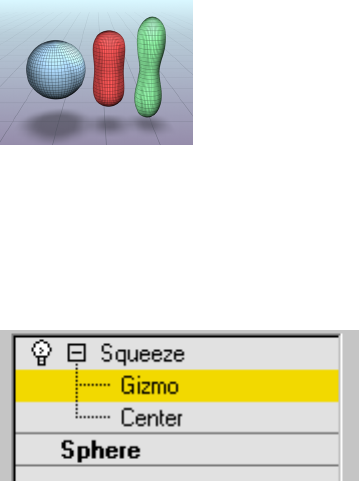
Squeeze Modifier
Modify panel > Make a selection. > Modifier List > Object-Space Modifiers >
Squeeze
Make a selection. > Modifiers menu > Parametric Deformers > Squeeze
The Squeeze modifier lets you apply a squeezing effect to objects, in which
the vertices closest to the object's pivot point on page 7895 move inward. The
squeeze is applied around the Squeeze gizmo's local Z axis. You can also use
Squeeze to create a bulge on the vertical axis, to accentuate the squeeze effect.
Left: Original object
Middle and Right: Varying squeeze amounts
Interface
Modifier Stack
Gizmo At this sub-object level, you can transform and animate the gizmo
like any other object, altering the effect of the Squeeze modifier. Translating
the gizmo translates its center an equal distance. Rotating and scaling the
gizmo takes place with respect to its center.
Center At this sub-object level, you can translate and animate the center,
altering the Squeeze gizmo's shape, and thus the shape of the squeezed object.
For more information on the stack display, see Modifier Stack on page 7427 .
1676 | Chapter 9 Modifiers
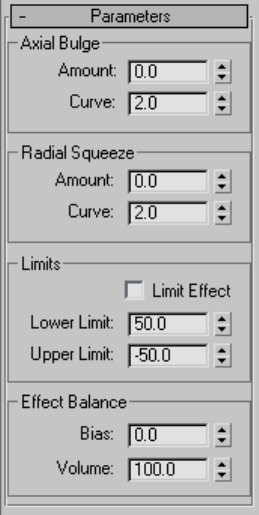
Parameters rollout
Axial Bulge group
These controls let you apply a bulge effect along the Squeeze gizmo's local Z
axis, which is aligned by default with the object's local Z axis.
Amount Controls the magnitude of the bulging effect. Higher values
effectively elongate the object and cause the ends to curve outward.
Curve Sets the degree of curvature on the bulging ends. You can use this to
control whether the bulge is smooth or pointy.
Radial Squeeze group
These controls let you apply a squeeze effect around the Squeeze gizmo's local
Z axis, which is aligned by default with the object's local Z axis.
Amount Controls the magnitude of the squeezing action. Values larger than
zero tend to constrict the "waist" of the object, and values less than zero tend
to bulge the waistline out, as if the object had been stepped on.
Squeeze Modifier | 1677
Curve Sets the degree of curvature into the squeeze. Low values cause a sharp
squeezing effect, while high values create a gradual, less pronounced squeeze.
Limits group
These controls let you limit the squeeze effect's extents along the local Z axis.
Limit Effect Limits the extent of the squeeze effect as defined by the Lower
and Upper Limit settings.
Lower Limit Sets the limit in the positive direction along the Z axis.
Upper Limit Sets the limit in the negative direction along the Z axis.
Effect Balance group
Bias Changes the relative amounts of bulge and squeeze while retaining a
constant object volume.
Volume Increases or decreases the effects of both Squeeze and Bulge in
parallel.
STL Check Modifier
Select an object. > Modify panel > Modifier List > STL Check
Select an object. > Modifiers menu > Mesh Editing > STL check
The STL Check modifier checks an object to see if it's correct for exporting
to an STL (stereolithography) file format on page 7076 . Stereolithography files
are used by specialized machines to produce prototype physical models based
on the data in the STL file.
To create a physical model, an STL file must have a complete and closed
surface. Using STL Check to test your geometry before you export it can save
time and money when the file is used to create the physical model.
1678 | Chapter 9 Modifiers
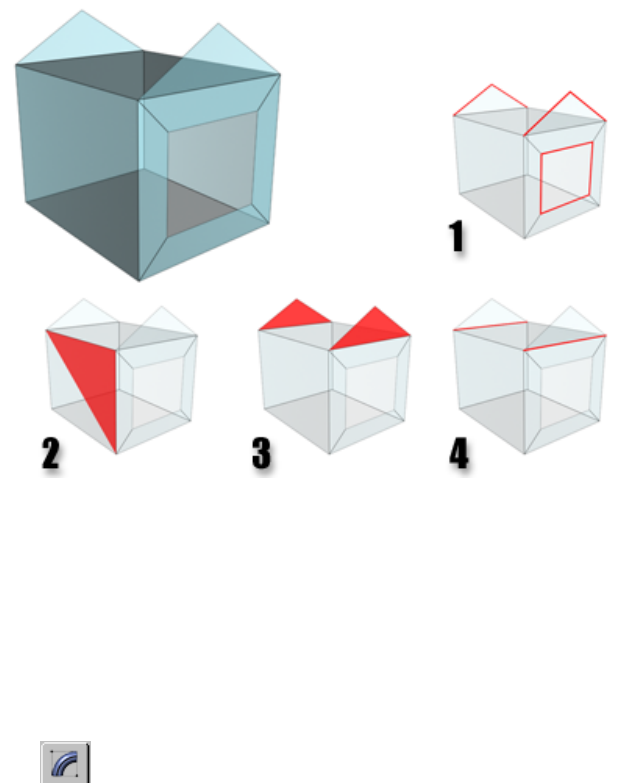
STL Check errors.
1. Open edges
2. Double face
3. Spikes
4. Multiple edges
Procedures
To check an object for STL compatibility:
1 Select the object, then on the Modify panel, choose Mesh Editing
> STL Check from the Modifier List.
2Turn on Check.
The message in the Status group shows if errors are found. STL Check
indicates errors by selecting the problem geometry, assigning it a special
material ID, or both.
STL Check Modifier | 1679
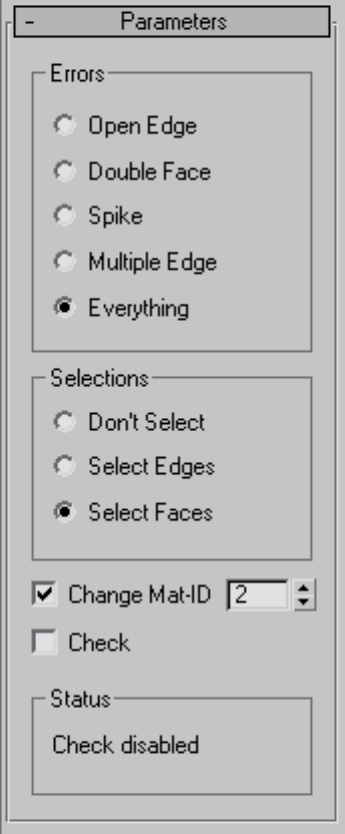
Interface
Errors group
Choosing one of these options selects incorrect geometry specific to the choice,
and selects it depending on the option chosen in the Selections group.
1680 | Chapter 9 Modifiers
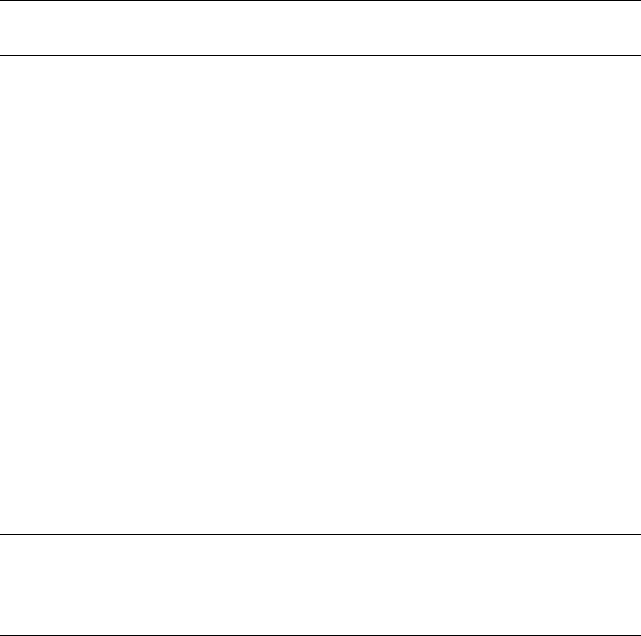
Open Edge Checks for open edges (holes).
Double Faces Checks for faces that share the same 3D space.
Spike Checks for spikes, which are isolated faces that share only one edge
with the object.
Multiple Edges Checks for faces that share more than one edge.
Everything Checks for all of the above.
TIP While checking Everything takes the longest amount of time, it is
recommended if you plan to use the STL file for generating a physical model.
Selections group
These options specify the level of incorrect geometry that's selected, based on
the settings in the Errors group.
Don't Select When on, STL Check doesn't select any part of objects in error.
Select Edges When on, STL Check marks the edges of faces in error by
selecting them. The selection of erroneous edges is visible in viewports.
Select Faces When on, STL Check marks the faces of any object in error by
selecting them. The selection of erroneous faces is visible in viewports.
Change Mat-ID When on (the default), STL Check also marks faces in error
by assigning them a unique material ID. Use the spinner to choose the value
of the material ID that STL Check uses.
Check Turn on to perform the STL check. For complex models, expect a
pause between the time you turn this on, and the time you see the reported
errors in the Status group. Default=off.
Status Displays the number of errors when Check is on.
TIP If Select Edges is turned off, you can see faces in error by applying an Edit
Mesh modifier on page 1283 and selecting by material ID at the Face sub-object
level. You can also assign a Multi/Sub-Object material on page 5558 to the object
to help you see where the errors are.
Stretch Modifier
Select an object. > Modify panel > Modifiers List > Object–Space Modifiers >
Stretch
Stretch Modifier | 1681
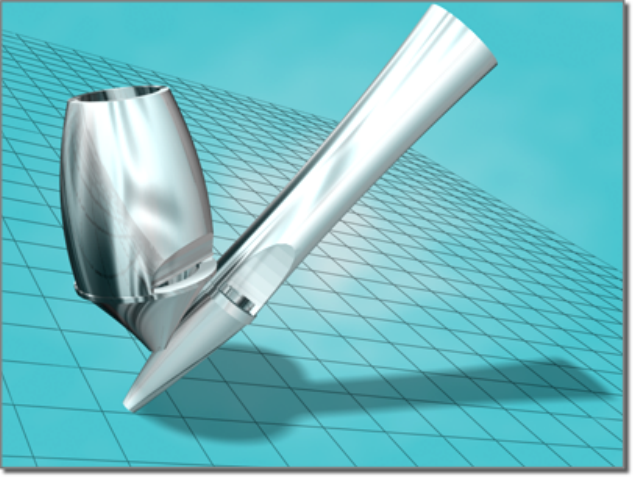
Select an object. > Modifiers menu > Parametric Deformers > Stretch
The Stretch modifier simulates the traditional animation effect of
"squash-and-stretch." Stretch applies a scale effect along a specified stretch
axis and an opposite scale along the two remaining minor axes.
The amount of opposite scaling on the minor axes varies, based on distance
from the center of the scale effect. The maximum amount of scaling occurs
at the center and falls off toward the ends.
Applying a Stretch modifier to the object on the left creates the object on the right.
Procedures
To stretch an object:
1Select an object.
2Apply Stretch.
3On the Parameters rollout > Stretch Axis group, choose X, Y, or Z.
4On the Parameters rollout > Stretch group, enter a value in the Stretch
field.
1682 | Chapter 9 Modifiers
5Adjust the Parameters rollout > Stretch group > Amplify setting to change
the amount of scaling along the minor axes.
To limit a stretch:
1Apply a Stretch modifier to an object and specify the stretch amounts
and stretch axis.
2On the Parameters rollout > Limits group, turn on Limit Effect.
3Set values for the Upper and Lower Limits to define the Stretch boundaries
on either side of the Stretch center.
4In the stack display, choose the Center sub-object level, and move the
center to locate the limited stretch effect.
Interface
Modifier stack
Gizmo At this sub-object level, you can transform and animate the gizmo
like any other object, altering the effect of the Stretch modifier. Translating
the gizmo translates its center an equal distance. Rotating and scaling the
gizmo takes place with respect to its center.
Center At this sub-object level, you can translate and animate the center,
altering the Stretch gizmo's shape, and thus the shape of the stretched object.
Stretch Modifier | 1683
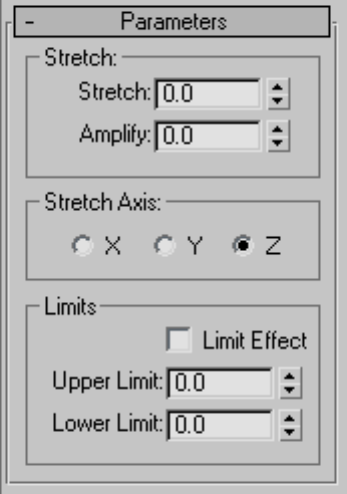
Parameters rollout
Use options in the Parameters rollout to set the following:
■Amount of stretch
■Major stretch axis
■Area affected by the stretch
Stretch group
The Stretch group of the Parameters rollout has two fields that control the
amount of stretch scaling applied.
Stretch Sets the base scale factor for all three axes. The scale factor derived
from the Stretch value varies according to the sign of the value.
■Positive stretch values define a scale factor equal to Stretch+1. For example,
a stretch value of 1.5 yields a scale factor of 1.5+1=2.5, or 250 percent.
1684 | Chapter 9 Modifiers
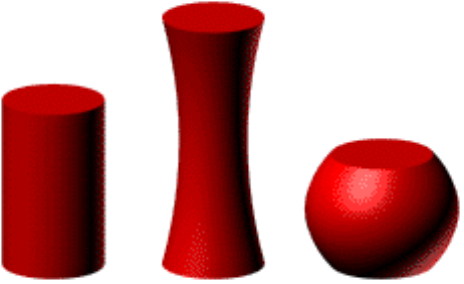
■Negative stretch values define a scale factor equal to -1/(Stretch-1). For
example, a stretch value of -1.5 yields a scale factor of -1/(-1.5-1)=0.4, or
40 percent.
The calculated scale factor is applied to the selected stretch axis and the
inverse scale is applied to the minor axes.
Stretch values of 0.0, 0.5, and -0.5
Amplify Changes the scale factor applied to the minor axes. Amplify generates
a multiplier using the same technique as stretch. The multiplier is then applied
to the Stretch value before the scale factor for the minor axes is calculated.
Amplify values affect scaling along the minor axes in the following way:
■A value of 0 has no effect. It uses the default scale factor calculated from
the Stretch amount.
■Positive values exaggerate the effect.
■Negative values reduce the effect.
Stretch Modifier | 1685
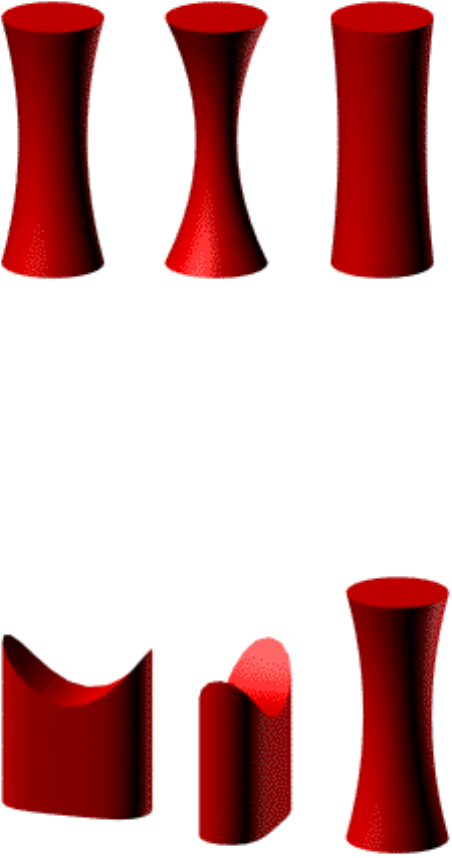
Stretched objects with Amplify values of 0.0, 1.0, and -1.0.
Stretch Axis group
You select which of the object's local axes is the Stretch Axis using options in
the Stretch Axis group of the Parameters rollout.
■The scale factor calculated from the Stretch Amount is applied to the Stretch
Axis.
■The inverse scale factor is applied to the remaining minor axes.
Effects of changing the Stretch axis
1686 | Chapter 9 Modifiers
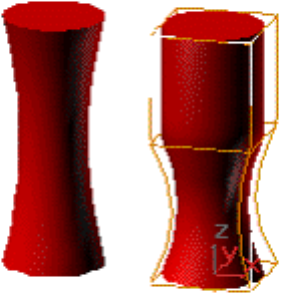
Limits group
You can apply the stretch effect to the entire object, or limit it to a portion
of the object, using controls in the Limits group of the Parameters rollout.
The limits restrict the stretch effect along the positive and negative Stretch
Axis as measured from the modifier's center.
Limit Effect Limits the stretch effect. When Limit Effect is turned off, values
in the Upper and Lower Limit fields are ignored.
Upper Limit Sets the boundary of the stretch effect along the positive Stretch
Axis. The Upper Limit can be 0 or any positive number.
Lower Limit Sets the boundary of the stretch effect along the negative Stretch
Axis. The Lower Limit can be 0 or any negative number.
Limiting the effect of Stretch
Click Sub-Object and move the modifier's center to change the location of
the limited stretch areas. The Upper and Lower Limit boundaries move with
the modifier center to maintain their specified distances.
Stretch Modifier | 1687
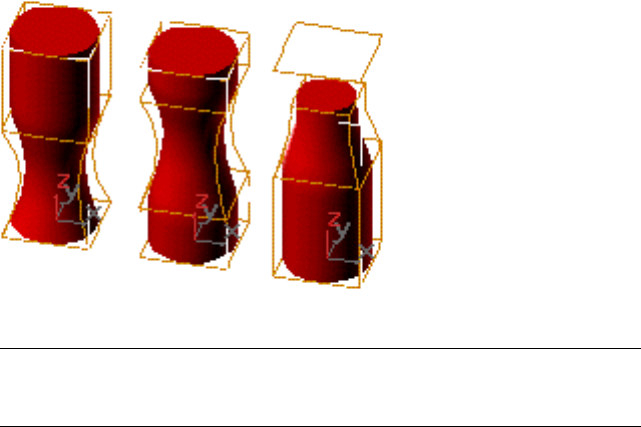
Effects of moving the Stretch center
NOTE You can also limit the stretch effect by using an Edit or Select modifier,
defining a sub-object selection, and then applying Stretch. If the modifier's
Sub-Object button is active, only the selected sub-objects will be stretched.
Subdivide Modifier
Make a selection. > Modify panel > Modifier List > Subdivide
Make a selection. > Modifiers menu > Radiosity Modifiers > Subdivide
The Subdivide modifier provides an algorithm for creating meshes used for
radiosity on page 5976 processing. Processing radiosity requires meshes that
have elements shaped as close as possible to equilateral triangles. The density
of the mesh also needs to be considered in determining the resolution of the
lighting details that need to be captured. The denser the mesh is, the finer the
lighting detail and accuracy will be. The trade-off is a larger memory
requirement and slower rendering times. The Subdivide modifier works on a
whole object and does not work on selected faces in a mesh.
1688 | Chapter 9 Modifiers
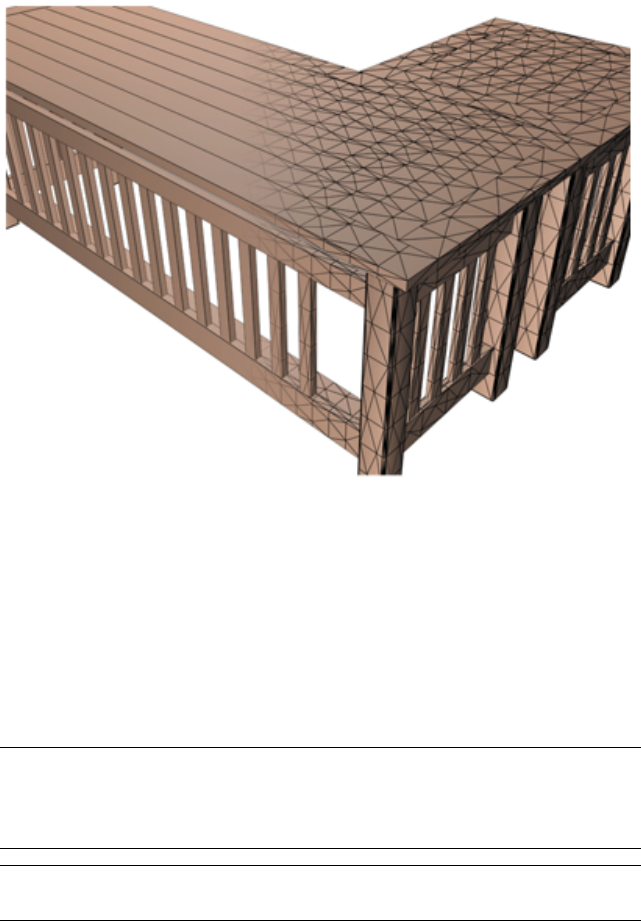
Subdivide modifier breaks flat surfaces into meshes.
Although it is primarily developed for increasing the quality of radiosity
solutions, the Subdivide modifier can also be used by any application that
requires well-formed meshes. For example, irregular mesh elements generated
for Terrain on page 703 compound objects can be improved.
The modifier has world space and object space variants. In the world space
modifier the size limit is on the mesh after it is transformed into world space
coordinates. The object space modifier limits the size in object space
coordinates.
NOTE Typically, the Subdivide modifier is applied automatically to objects in the
scene when a radiosity solution is processed. Meshing parameters can be set on
a global basis in the radiosity control panel on page 5995 or for individual objects
in the Object Properties dialog on page 245 .
TIP When you are satisfied with the subdivision settings on one object, you can
drag the modifier to other objects to propagate it.
Subdivide Modifier | 1689
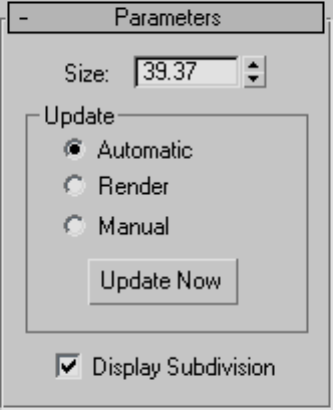
Interface
Size Controls the size of triangles in the subdivided mesh. The length of the
longest edge of any triangle will not exceed the square root of 2 times the size
in the Subdivide modifier. The square root of 2 factor is used, so that a square
whose edges are the size will not be subdivided.
Update group
The radio buttons in the Update group control when the meshing is done.
Automatic Updates immediately when changes are made to the controls or
the mesh.
Render Updates only for rendering.
Manual Updates only when Update Now is pressed. Subdivision can be
interrupted using the Esc key. If the subdivision is interrupted the Update
mode is changed to Manual.
Update Now Updates the mesh when Manual is turned on.
Display Subdivision Controls whether all of the triangles are visible, or only
the edges where face properties are changing. Allows you to reduce the visible
triangles in the scene if it appears cluttered.
1690 | Chapter 9 Modifiers
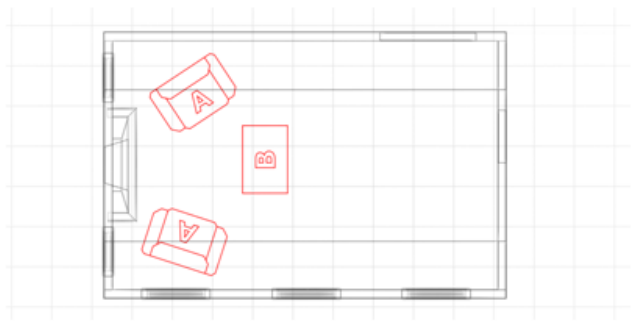
Substitute Modifier
Make a selection. > Modify panel > Modifier List > Object-Space Modifiers >
Substitute
Typically, designers use two-dimensional shapes to represent objects, such as
furniture, in their AutoCAD designs. However, when they link their DWG
files on page 7762 into 3ds Max for visualization, they want to see how the
objects will look in their design.
Top view of 2D symbols used to represent 3D objects
The Substitute modifier lets you quickly replace one or more objects with
another in the viewports or at render time. The substitute object can be
instanced from the current scene or can be referenced from an external file.
Substitute Modifier | 1691
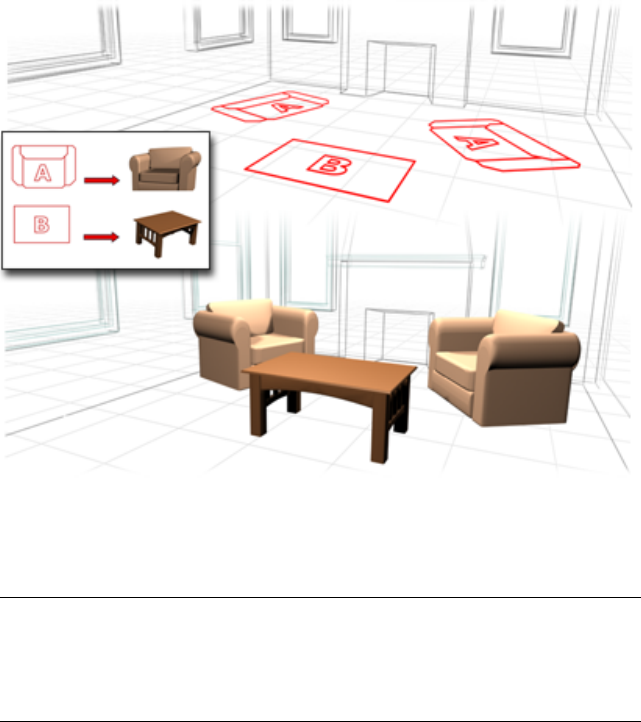
The Substitute modifier replaces the 2D objects with their 3D counterparts.
To get rid of the substitute object, simply remove the modifier from the stack.
This frees up the memory required to store it.
TIP When you file link to a DWG file, the file is imported to 3ds Max as groups of
VIZBlocks on page 7967 . If the pivot points of the VIZBlock and the substituted
geometry do not match, you may not obtain the desired results. Adjust the pivot
point of the VIZBlock object using the Adjust Geometry button to align the
substituted geometry correctly.
See also:
■XRef Objects on page 6732
■XRef Scene on page 6755
Procedures
To use an object from the current scene as a substitute:
1Select an object, and then apply the Substitute modifier.
1692 | Chapter 9 Modifiers
2Click Pick Scene Object, and then in the viewport, select an object to
substitute for the selection.
Alternatively, click the ... button to the right of Pick Scene Object and
select an object from the dialog that is displayed.
The original object is replaced by an instance of the substitute object.
3To see the original object in the viewport, turn off In Viewport. To see
the original object in the final rendering, turn off In Render. To
permanently disable the substitution, delete the modifier.
To use an externally referenced object as a substitute:
1Select an object, and then apply the Substitute modifier.
2Click Select XRef Object.
3Use the Open File dialog to designate the file that contains the substitute
object you want to use.
4Use the XRef Merge dialog on page 6752 to designate the object to use as
a substitute.
The original object is replaced by an instance of the substitute object.
To see the original object in the viewport, turn off Display group > In
Viewport. To see the original object in the final rendering, turn off Display
group > In Render. To permanently disable the substitution, delete the
modifier.
Interface
Modifier Stack
Substitute Object At this sub-object level, you can transform the substitute
object without affecting the original, changing the offset distance between
them. Otherwise, transforming the substitute object affects both equally.
Substitute Modifier | 1693
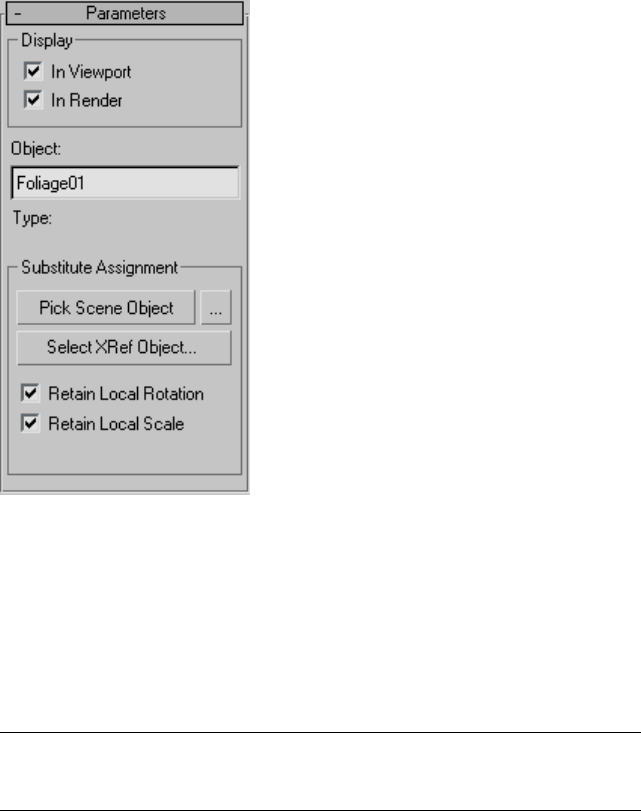
Parameters rollout
Display group
In Viewport Replaces the original object with the substitute in the viewports.
In Render Replaces the original object with the substitute when you render
the scene.
Object This editable text field displays the name of the substitute object and
lets you rename it.
NOTE The name, if changed, appears only on the Modify panel at the current
stack level. That is, the name is local to the current application of the Substitute
modifier.
Type (label) Displays the type of object used as a substitute. If you use a
scene object, the type is shown as Instance. If you use an XRef object, the type
is shown as XRef Object. Appears only after you designate a substitute object.
1694 | Chapter 9 Modifiers

Substitute Assignment group
Pick Scene Object Lets you choose an object from the current scene to be
instanced as a substitute for the selected object. Click Pick Scene Object, and
then select the object from a viewport to use as a substitute. If In Viewport is
on and Retain Current Position is off (the default settings), an instance on
page 7818 of the substitute object appears in the place of the original object.
The mouse cursor changes to a plus sign (+) when over an object that can be
used as a substitute. You cannot use an object to which the Substitute modifier
is applied as a substitute object.
Use the button labeled "..." to the right of Pick Scene Object to choose a
substitute object using the Select Substitute Object dialog, which works like
the Select From Scene dialog on page 168 . In the dialog's list window, highlight
the object to use as a substitute, and then click Select.
Select XRef Object Lets you specify an object to be instanced from an external
scene file as the substitute. Click Select XRef Object, and then, in the Open
File dialog, open the file containing the substitute object. On the XRef Merge
dialog on page 6752 , select the substitute object and then click OK. Objects to
which the Substitute modifier is applied don't appear in the list.
NOTE Because the object used as a substitute is referenced from an external file,
any changes to the object in that file apply to the substitute after reloading. For
example, if you apply a Bend modifier to the substitute object in the external file,
then the next time you load the file containing the object with the Substitute
modifier, it appears bent.
Retain Local Rotation/Scale When on, rotates or scales the new object
instance in the same place as the substitute object you select. In this case, the
two objects coincide in space, and you must move one to see both. When off,
3ds Max positions the instanced substitute object in the same place as the
object containing the Substitute modifier.
You must specify the Retain Local Rotation/Scale setting before designating
the substitute object. Changing this setting afterward has no effect.
Surface Modifier
Select a spline object. > Modify panel > Modifier List > Object-Space Modifiers
> Surface
Select a spline object. > Modifiers menu > Patch/Spline Editing > Surface
Surface Modifier | 1695
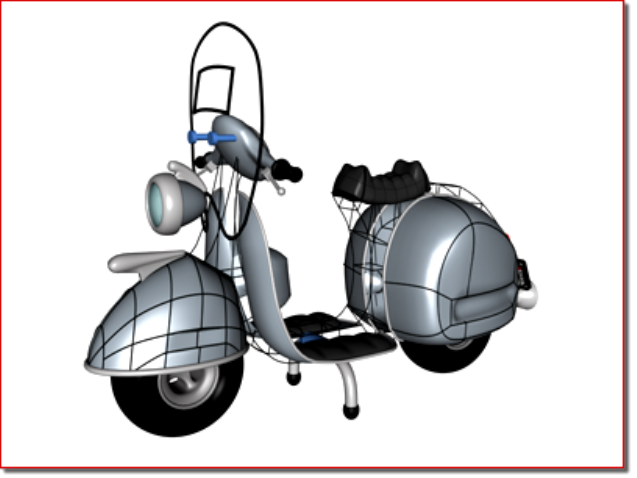
Procedures on page 1703 Interface on page 1706
The Surface modifier generates a patch surface based on the contours of a
spline network. A patch is created wherever the segments of the interwoven
splines form a three- or four-sided polygon. The Surface modifier and the
CrossSection modifier, taken together, are referred to as Surface Tools. They
allow you to create complex or organic surfaces, like the fuselage of a plane,
or a three-dimensional character.
Applying the Surface modifier to create a patch surface.
The CrossSection modifier on page 1259 can be applied before the Surface
modifier to connect splines representing cross-sections. Once the basic spline
network is created and the Surface modifier is applied, the model can be
adjusted by editing the splines using an Edit Spline modifier below the Surface
modifier in the modifier stack. Since the Surface modifier creates a Patch
surface, further refinements can be made to the patch model by adding an
Edit Patch modifier above the Surface modifier.
The bulk of the work in using Surface tools to model lies in creating and editing
splines in an Editable Spline or Edit Spline modifier. One of the benefits to
modeling using splines and Surface Tools is the ease of editing the model. At
almost any stage of modeling, you can add a nostril, ear, limb or body by
1696 | Chapter 9 Modifiers
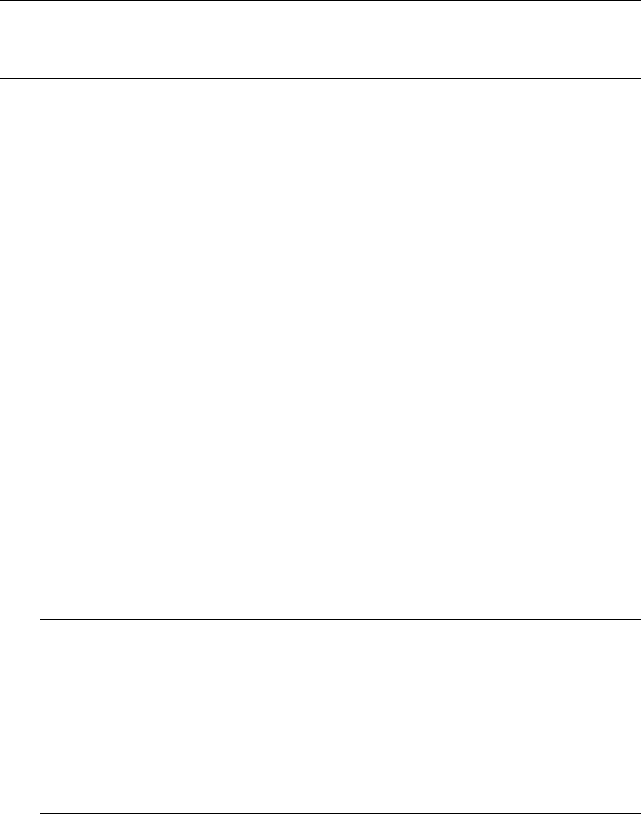
simply adding splines. This lends itself to a free-form approach to organic
modeling: you have a mental image of what you want, then you create and
edit the spline network until you are satisfied.
NOTE 3ds Max offers a simplified workflow for this modeling technique, using
Edit/Editable Spline and the Edit Patch modifier. For details, see To create a patch
object using the Cross Section and Spline Surface tools: on page 1291 .
Surface Modifier Basics
1Create a spline object.
2Make sure that the Spline vertices form valid three-sided or four-sided,
closed regions. Vertices on splines that cross one another should be
coincident.
To make spline vertices coincident, drag vertices over each other with
3D Snap turned on. 3D Snap must have the Vertex or End Point option
turned on. With 3D Snap turned on, you can snap to vertices on existing
splines as you create new splines. You can also select vertices and use the
Fuse option in an Editable Spline to make vertices co-incident.
3Use the CrossSection modifier to connect spline cross-sections, unless
you plan on manually creating the splines that connect the model's
cross-sections.
4Apply the Surface modifier, then adjust the weld threshold to generate
a patch object. Ideally all spline vertices that will form a patch surface
are coincident; the Threshold parameter allows patch creation even if
vertices are not quite coincident.
5Optionally, add an Edit Patch modifier to edit the patch surface.
TIP Make a reference copy of the spline object, then add the Surface modifier
to the copy and edit the original. As you edit the original spline object, patches
appear on the reference copy as splines form three-or four-sided shapes. This
allows you to view a shaded surface as you model.
You can take this a step further and add a Mirror modifier to the reference
copy. As you create splines for one side of a head or body, the reference
copy displays an entire model.
Surface Modifier | 1697
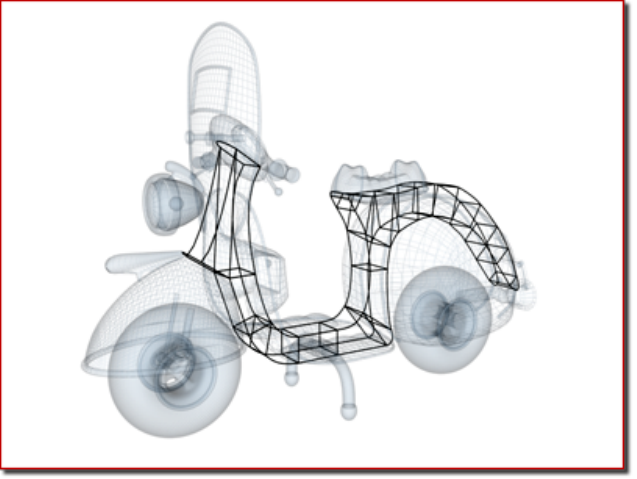
Modeling with Surface Tools
There are two primary methods of using the Surface modifier to create patch
models.
■Create splines that represent a model's cross sections, add the CrossSection
modifier to connect the cross sections, and apply the Surface modifier to
create the patch surface. This approach works for models like the body of
an airplane.
Alternatively, use the editable spline Cross Section function on page 605
to connect the cross sections, and then use the editable patch Spline
Surface tools on page 1292 to create the surface.
■Create a network of splines manually, and then apply the Surface modifier
or editable patch Spline Surface tools to create the patch surface. This
approach works for modeling a face or body of a character.
Modeling Examples
1698 | Chapter 9 Modifiers
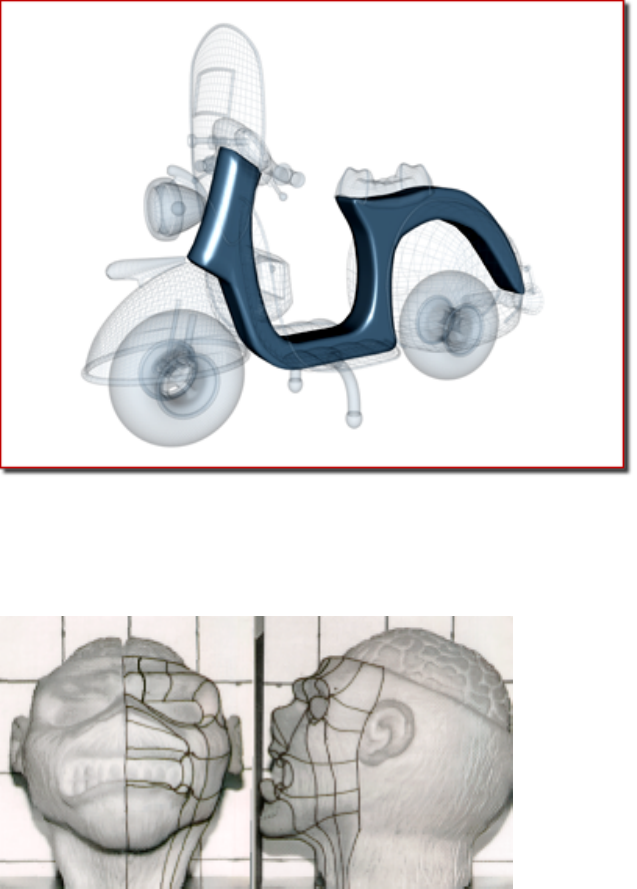
Scooter: Splines form cross sections of the body
One method of using Surface Tools is to create splines that represent a model's
cross sections, then the CrossSection and Surface modifiers are applied to
create the patch surface.
Surface Modifier | 1699
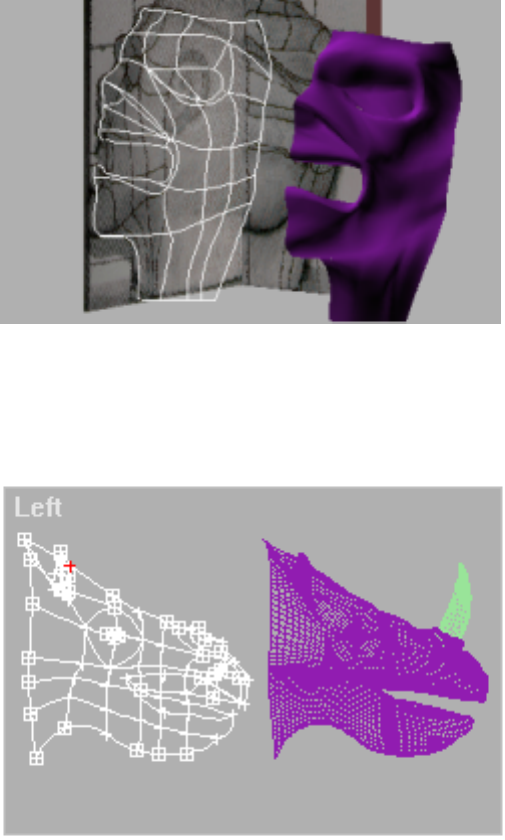
Face: Spline network based on front and profile reference images
Two intersecting texture-mapped polygons are used as a reference to create a
network of splines manually. Drawing lines on the physical sculpture is used
as an added visual aid to position the splines in this case. The CrossSection
modifier is not necessary if you create the spline network manually.
1700 | Chapter 9 Modifiers
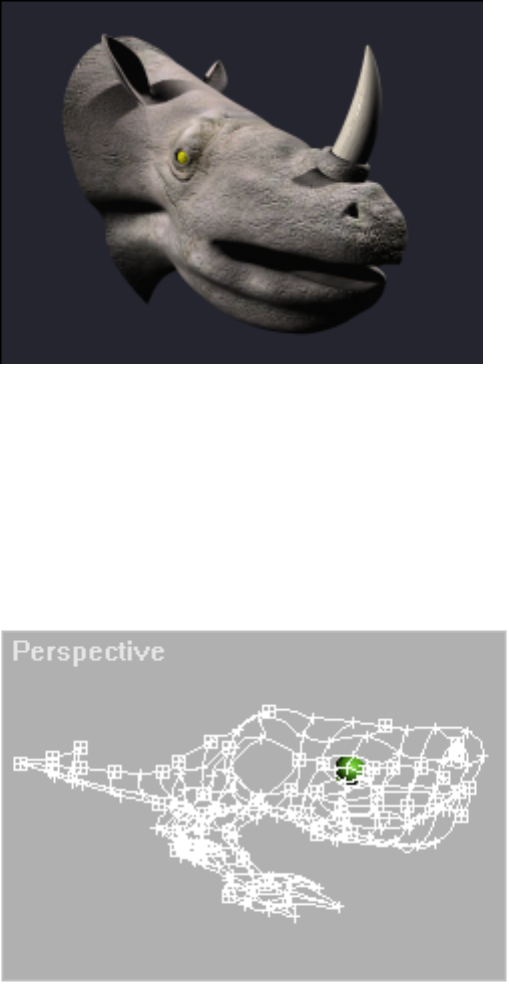
Rhino head: Spline network begins with the profile.
In the top image, the head of a rhinoceros is modeled by creating a network
of splines. The first spline created is the profile of the rhino; other splines are
added and edited to complete the model. In this case, a reference copy of the
spline model was created and a Surface modifier was added to the copy.
As the spline network is edited, the patch surface of the reference copy is
updated dynamically. This allows you to view a shaded patch model as you
manipulate the spline network, any surface anomalies can be spotted and
corrected.
Surface Modifier | 1701
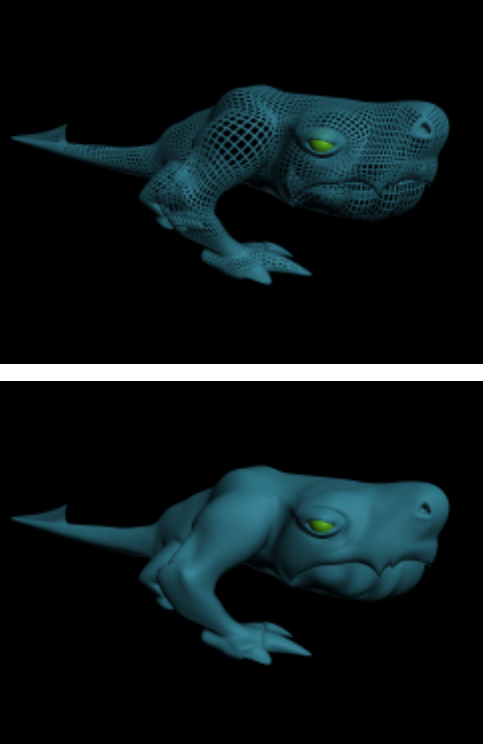
Sequence of images showing the spline network, the patches created by the Surface
modifier, and a shaded view of an alien character.
Additional Details
■Splines are initially created using the tools in Create panel > Shapes >
Splines > Object Type rollout, such as Line on page 551 , Circle on page
557 , Arc on page 560 , and Section on page 576 . Splines can also be created
using the Create Line command in an Editable Spline or and Edit Spline
modifier.
1702 | Chapter 9 Modifiers
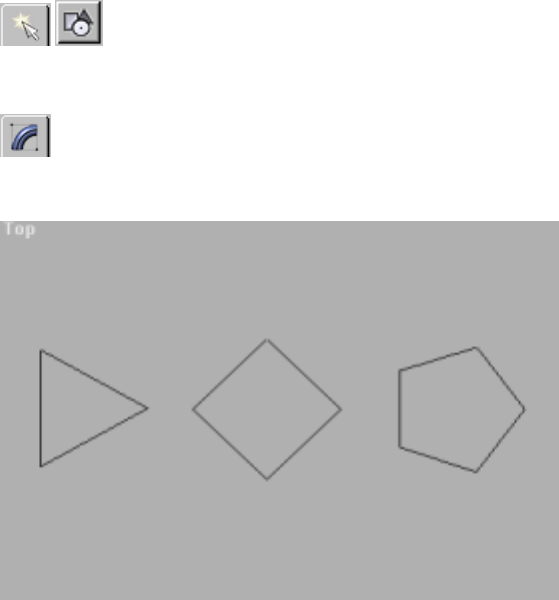
■Splines are edited by applying an Edit Spline modifier to the selected spline
object or editing parameters in an Editable Spline. Editing splines changes
the patch surface created by the Surface modifier.
■To add splines to a spline object, use the Attach command in the Edit
Spline modifier.
■Within a spline object, splines need not be continuous. A spline object
may consist of ten splines, for example. As long as the spline vertices are
coincident, or close enough for the Threshold parameter in the Surface
modifier to weld them together, a surface will be generated.
Procedures
Example: Understanding valid splines:
1 In the Top viewport, use Create panel > Shape > NGon to
create three NGons: a three-sided, four-sided, and five-sided NGon, each
about 100 units wide.
2 Make sure that all the splines form one object. Do this by applying
an Edit Spline modifier to one of the NGons and using Attach to add the
remaining NGon objects.
Surface Modifier | 1703
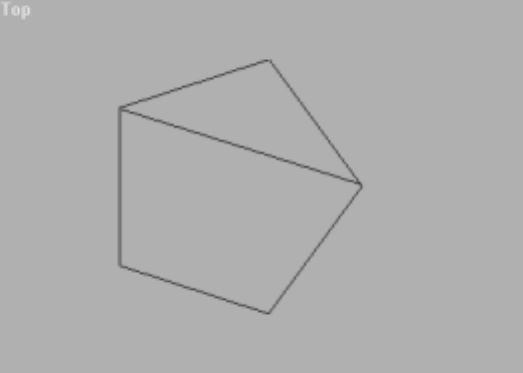
3Choose Modifiers menu > Patch/Spline Editing > Surface from the Modifier
List.
Notice that the three- and four-sided splines formed patches but the
five-sided NGon did not. The five-sided spline does not form a three- or
four-sided closed region. To make it a valid spline, a line must bisect the
NGon to form a three- and four-sided region.
4In the stack display, choose the Edit Spline modifier again. Turn on Create
Line on the Geometry rollout, and create a line that bisects the five-sided
NGon.
The start and end points of the line should overlap the vertices on the
NGon. Being exact is not critical; the Threshold parameter fuses spline
vertices based on their proximity.
1704 | Chapter 9 Modifiers
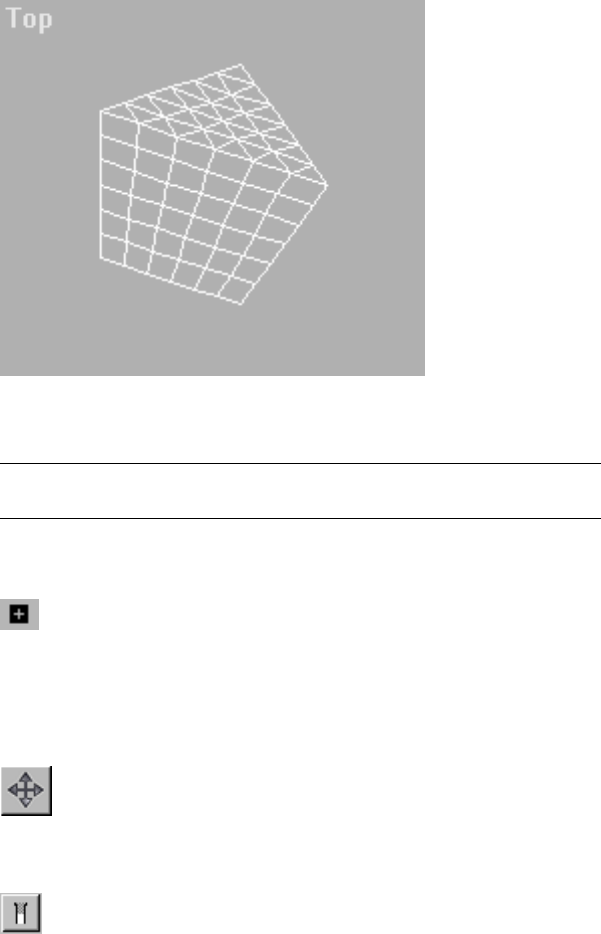
5In the stack display, choose the Surface modifier again. Now the five-sided
NGon is a patch object, consisting of a quad patch and a tri patch.
NOTE If the spline object did not turn into a patch, increase the Surface
modifier's Threshold parameter until the patches appear.
Example continued: Adjusting the shape of the spline:
1 In the stack display, expand the Edit Spline modifier's hierarchy,
and choose the Vertex sub-object level.
2In the Top viewport, select the top vertex of the five-sided NGon.
Two vector handles are displayed. These handles can be moved on any
axis.
3 Turn on Select and Move on the toolbar, then drag the handles
around in the Top viewport.
The shape of the spline changes.
4 Below the stack display, turn on the Show End Result On/Off Toggle
button.
The patch changes shape to fit the spline.
Surface Modifier | 1705
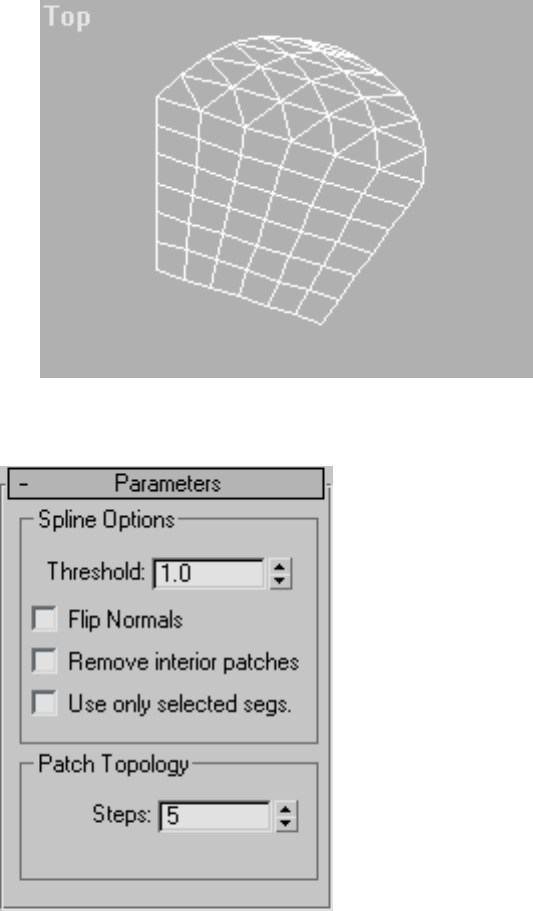
Interface
1706 | Chapter 9 Modifiers
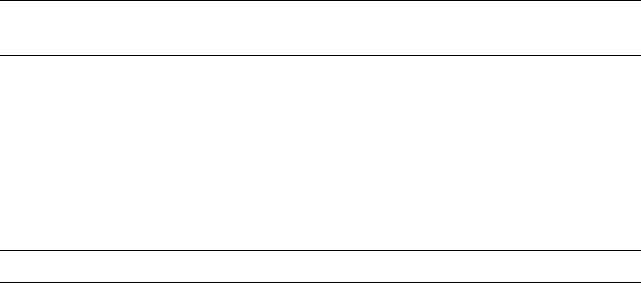
Spline Options group
Threshold Determines the overall distance that is used to weld the vertices
of the spline object. All vertices/vectors within the threshold of each other
are treated as one. Threshold uses units set in the Units Setup dialog on page
7601 .
NOTE Spline control handles are also treated as vertices, so setting high Threshold
levels can produce unexpected results.
Flip Normals Flips the normal direction of the patch surface.
Remove Interior Patches Removes interior faces of an object that you would
not normally see. These are the faces created within the caps or other interior
patches of the same type of a closed polygon.
Use only selected segs Only segments selected in the Edit Spline modifier
will be used by the Surface modifier to create patches.
NOTE Segment Sub-Object does not have to be left on in the Edit Spline modifier.
Patch Topology group
Steps The steps field spinner determines how many steps are used between
each vertex. The higher the step count, the smoother the curve you will get
between vertices.
SurfDeform Modifier
Select an object. > Modify panel > Modifiers List > Object–Space Modifiers >
SurfDeform
Select an object. > Modify panel > Modifiers List > World–Space Modifiers >
SurfDeform
Select an object. > Modifiers menu > Animation Modifiers > SurfDeform
Select an object. > Modifiers menu > Animation Modifiers > SurfDeform
(WSM)
The SurfDeform modifier works the same way as the PatchDeform modifier
on page 1525 , except that it uses a NURBS Point or CV surface instead of a patch
surface to apply surface deformation.
SurfDeform Modifier | 1707
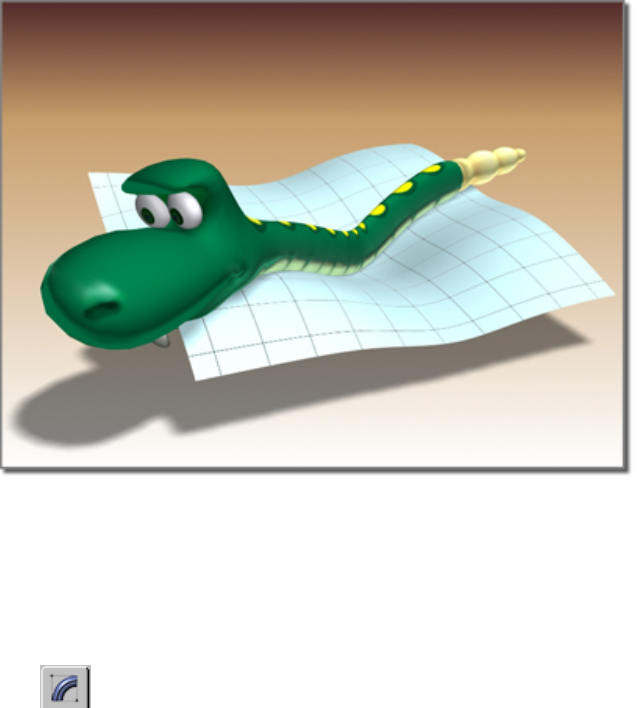
SurfDeform shapes how the snake rests.
Procedures
To use the SurfDeform modifier:
1Select an object.
2 From the Modify panel > Modifier List, choose Object–Space
Modifiers > SurfDeform.
3On the Parameters rollout, click Pick Surface.
4Select a NURBS Point or CV surface.
5Deform the object by adjusting the controls in the Surface Deform group.
1708 | Chapter 9 Modifiers
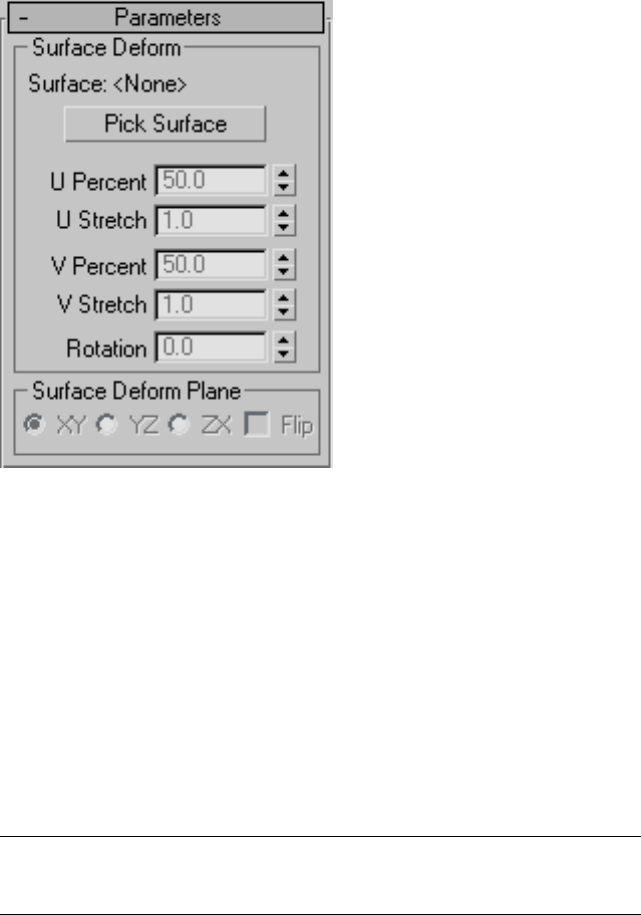
Interface
See PatchDeform modifier on page 1525 for a description of the user interface.
Sweep Modifier
Modify panel > Select a 2D shape. > Modifier List > Sweep
Select a 2D shape. > Modifiers menu > Patch/Spline Editing > Sweep
The Sweep modifier is used to extrude a cross-section along an underlying
spline or NURBS curve path. It is similar to the Loft compound object but is
a more efficient method. The Sweep modifier allows you to work with a series
of pre-made cross-sections such as angles, channels and wide flanges. You can
also use your own splines or NURBS curves as custom sections that you create
in 3ds Max or import from other MAX files.
NOTE This modifier is similar to the Extrude modifier in that once the Sweep is
applied to a spline, the end result is a 3D mesh object. Both sections and paths
can contain multiple splines or multiple NURBS curves.
Sweep Modifier | 1709
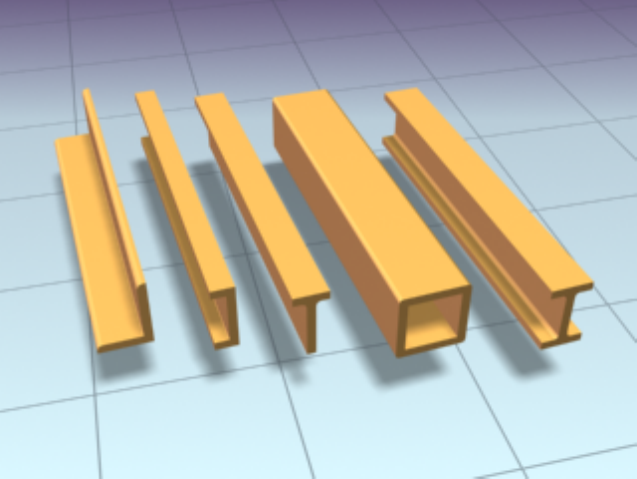
This modifier is very useful for creating structural steel details, molding details,
or in any situation where you need to extrude a section along a spline.
Examples of extrusions created with the Sweep modifier
Procedures
To apply the Sweep modifier to a line:
1Create a line in the perspective viewport.
2Apply the Sweep modifier to the line.
The line takes on the shape of an angled extrusion.
3Open the Built-In Section list and choose a different section.
The line now has the new section swept along its length.
To use a custom section with the Sweep modifier:
1Create a line and a six sided NGon in the perspective viewport.
2Apply the Sweep modifier to the line.
The line takes on the shape of an angled extrusion.
1710 | Chapter 9 Modifiers
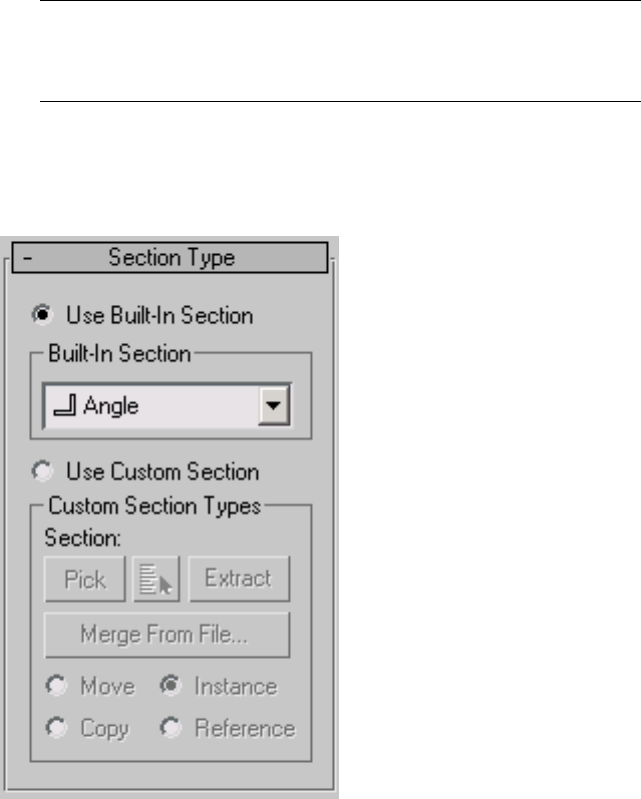
3Click the Use Custom Section radio button.
The line displays as a line again.
4Click the Pick button in the Custom Section Types group and choose the
NGon in the viewport.
The hexagonal shape is swept along the line's length.
NOTE If you find that you need to rescale the Custom Section shape, the
effects of using a transform like Select and Squash or Non-Uniform Scale will
not be reflected when swept. You need to apply an XForm modifier on page
1922 to the section and then rescale the XForm modifier's gizmo.
Interface
Section Type rollout
Use Built-In Section Choose this to use one of the included stock sections.
Sweep Modifier | 1711

Built-In Section group
Built-In Section list Clicking the arrow button for this list displays common
structural sections.
■Angle section Sweeps a structural angle section
along the spline. Default section=Angle.
■Bar section Sweeps a 2D rectangular section along
the spline.
■Channel section Sweeps a structural channel section
along the spline.
■Cylinder section Sweeps a solid 2D circle section
along the spline.
■Half Round section This section produces a half
round extrusion along the spline.
■Pipe section Sweeps a circular hollow tube section
along the spline.
■Quarter Round section Useful for molding details;
this section produces a quarter round extrusion along the spline.
■Tee section Sweeps a structural tee section along
the spline.
1712 | Chapter 9 Modifiers
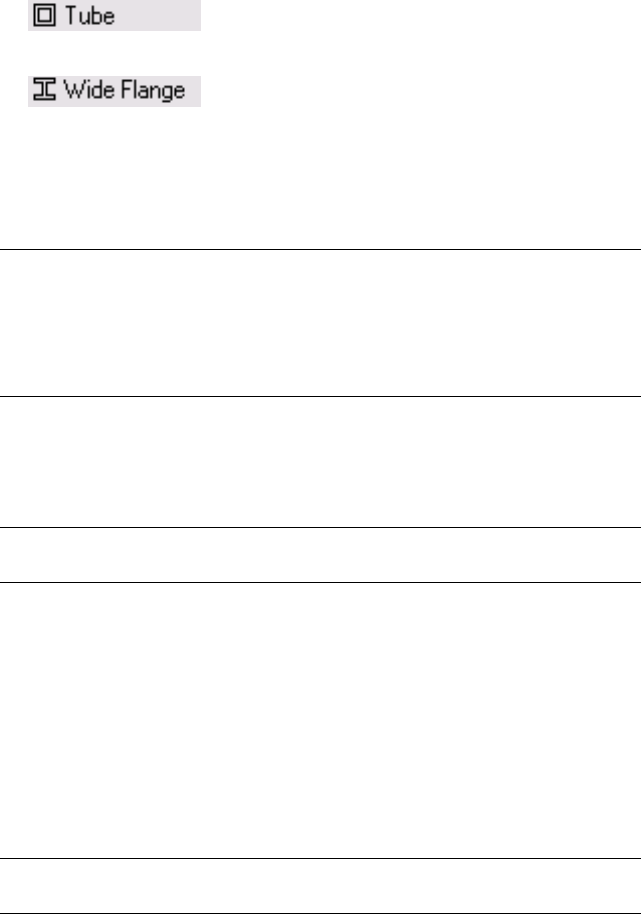
■Tube section Based on a square, this sweeps a hollow
tube section along the spline. Similar to the Pipe section.
■Wide Flange section Sweeps a structural wide flange
section along the spline.
Use Custom Section Choose this if you've created your own section or there
is another shape in the current scene or in another MAX file that you'd like
to use as your section.
NOTE Using a 2D shape as the Sweep modifier’s custom section will yield the
most predictable results. If using a 3D shape as the custom section, for the most
predictable results the base object should be a straight line or smooth path like a
circle or an arc. The same applies to custom sections made up of multiple splines.
You'll get the best results attained by insuring that all vertices in all the shapes are
coplanar.
Custom Section Types group
Section Displays the name of the custom shape you've selected. This area is
blank until you select a custom shape.
NOTE You can switch from a custom section to a built-in section and back without
having to pick the custom-section shape again from the viewports.
Pick If the custom shape you want to use is visible in the viewport, click the
Pick button and then pick the shape directly from the scene.
Pick Shape Click the Pick Shape button to open the Pick Shape dialog on
page 1728 . This dialog shows only valid shapes that are currently in the scene.
Extract Lets you create a new shape in the scene that is either a copy,
instance, or reference of the current custom section. Opens the Extract Shape
dialog on page 1730 .
Merge From File Lets you choose a section that is stored in another MAX
file. Opens the Merge File dialog on page 1731 .
NOTE When you use the Merge from File option, you will not be able to Undo
your work.
Move Sweeps the custom section along the specified spline. Unlike the
Instance, Copy and Reference switches, the selected section is moved to the
Sweep Modifier | 1713
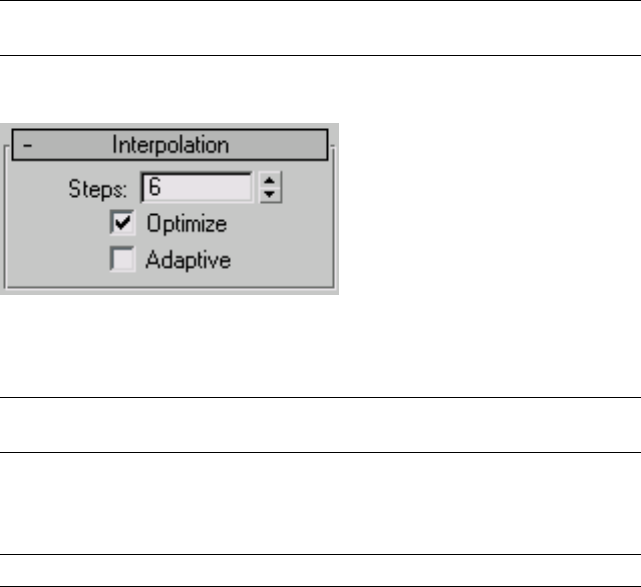
spline. Editing the original shape in the viewports has no effect on the Sweep
mesh.
Copy Sweeps a copy of the selected section along the specified spline.
Instance Sweeps an instance on page 7818 of the selected section to the
specified spline.
Reference Sweeps a reference on page 7910 of the selected section along the
specified spline.
NOTE When using Instance or Reference, adding modifiers to or editing the
original section in the viewports will change the Sweep mesh.
Interpolation rollout (Sweep modifier)
The controls in the Interpolation rollout of the Sweep modifier work exactly
as they do for any other spline. However, the controls affect only the built-in
section you've chosen, not the spline that the section is swept along.
NOTE If you want to change the interpolation settings of the underlying spline
path, you need to select the path object in the modifier stack.
In general, all spline curves are divided into small straight lines that
approximate a true curve. The number of divisions between each vertex on
the spline are called steps. The more steps used, the smoother the curve appears.
NOTE The Interpolation rollout is only active when built-in sections are used.
1714 | Chapter 9 Modifiers
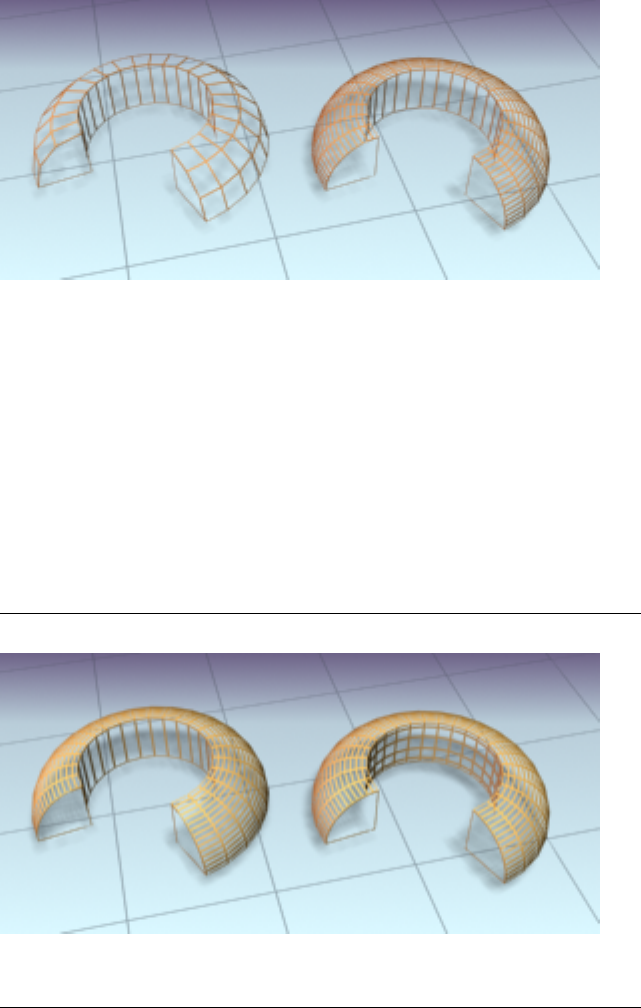
Left: The quarter-round section is set to zero steps.
Right: The same section on the right is set to four steps.
Steps Sets the number of divisions, or steps, the program uses between each
built-in section's vertices. Splines with tight curves require many steps to look
smooth while gentle curves require fewer steps. Range=0 to 100.
Spline steps can be either adaptive or manually specified. The method used
is set by the state of the Adaptive switch. The main use for manual
interpolation is to create splines for morphing or other operations where you
must have exact control over the number of vertices created.
Optimize When on, removes unneeded steps from straight segments in the
spline. Default=on.
NOTE Optimize is not available when Adaptive is on.
Left: Optimize is on for the left-hand sweep.
Right: Optimize is off for the right-hand sweep.
Sweep Modifier | 1715
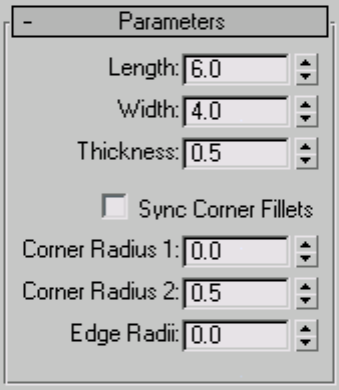
Adaptive When on, automatically sets the number of steps for each spline
to produce a smooth curve. Straight segments always receive 0 steps. When
off, enables manual interpolation control using Optimize and Steps.
Default=off.
Parameters rollout
The Parameters rollout is context-sensitive and displays different settings
depending upon the built-in section you've chosen to sweep along a spline.
For example, more complex sections such as the Angle have seven settings
that you can change whereas the Quarter-Round has only one setting.
Parameters rollout – Angle
Length Controls the height of the vertical leg of the angle section.
Default=6.0.
Width Controls the width of the horizontal leg of the angle section.
Default=4.0.
Thickness Controls the thickness of both legs of the angle. Default=0.5.
Sync Corner Fillets When turned on, Corner Radius 1 controls the radius of
both the interior and exterior corners between the vertical and horizontal
legs. It also maintains the thickness of the section. Default=off.
Corner Radius 1 Controls the exterior radius between the vertical and
horizontal legs of the angle section. Default=0.0.
1716 | Chapter 9 Modifiers
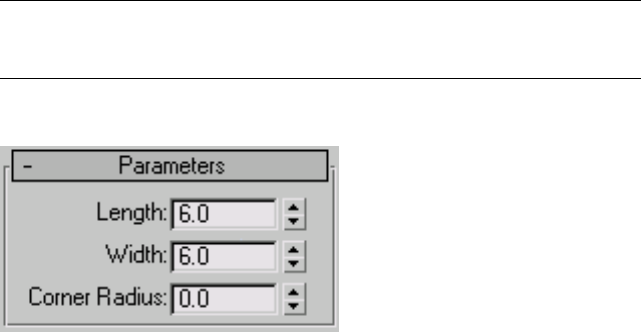
Corner Radius 2 Controls the interior radius between the vertical and
horizontal legs of the angle section. Default=0.5.
Edge Radii Controls the interior radius at the outermost edges of the vertical
and horizontal legs. Default=0.0.
NOTE Be cautious when adjusting these settings. There are no constraining
relationships between them. Therefore, it's possible to set an inside radius (Corner
Radius 2) that is greater than the length or width of the legs of the angle.
Parameters rollout – Bar
Length Controls the height of the bar section. Default=6.0.
Width Controls the width of the bar section. Default=6.0.
Corner Radius Controls the radius of all four corners of the section.
Default=0.0.
Sweep Modifier | 1717
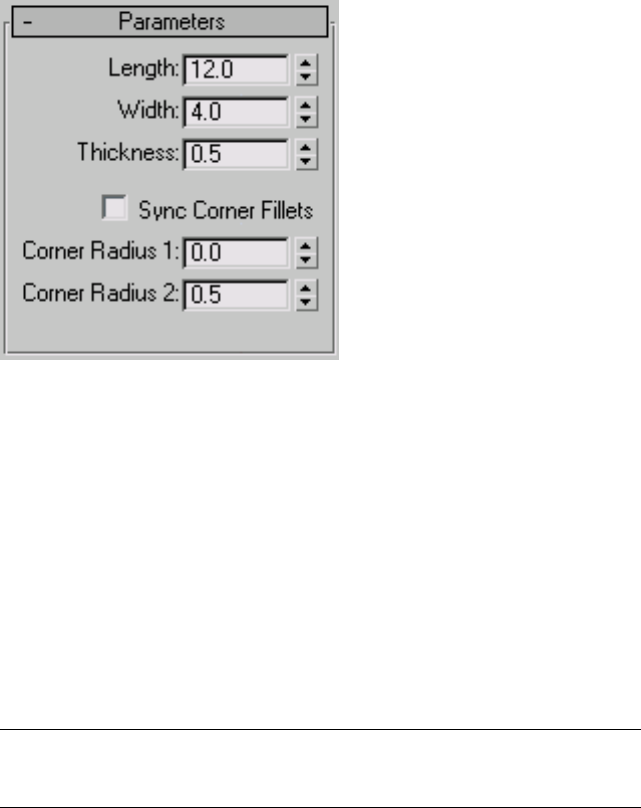
Parameters rollout – Channel
Length Controls the height of the vertical web of the channel section.
Default=12.0.
Width Controls the width of the top and bottom horizontal legs of the
channel section. Default=4.0.
Thickness Controls the thickness of both legs of the channel. Default=0.5.
Sync Corner Fillets When on, Corner Radius 1 controls the radius of both
the interior and exterior corners between the vertical web and horizontal legs.
It also maintains the thickness of the section. Default=off.
Corner Radius 1 Controls the exterior radius between the vertical web and
horizontal legs of the channel. Default=0.0.
Corner Radius 2 Controls the interior radius between the vertical web and
horizontal legs of the channel. Default=0.5.
NOTE Be cautious when adjusting these settings. There are no constraining
relationships between them. Therefore, it's possible to set an inside radius (Corner
Radius 2) that is greater than the length of the web or width of the legs.
1718 | Chapter 9 Modifiers
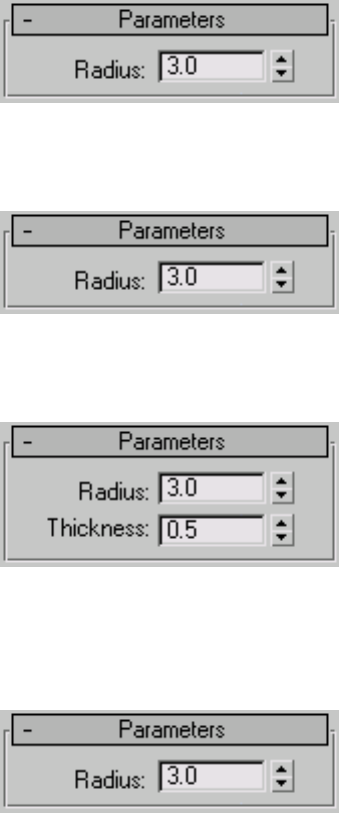
Parameters rollout – Cylinder
Radius Controls the radius of the cylinder section. Default=3.0.
Parameters rollout – Half-Round
Radius Controls the radius of the half round section. Default=3.0.
Parameters rollout – Pipe
Radius Controls the exterior radius of the pipe section. Default=3.0.
Thickness Controls the thickness of the wall of the pipe. Default=0.5.
Parameters rollout – Quarter-Round
Radius Controls the radius of the quarter round section. Default=3.0.
Sweep Modifier | 1719
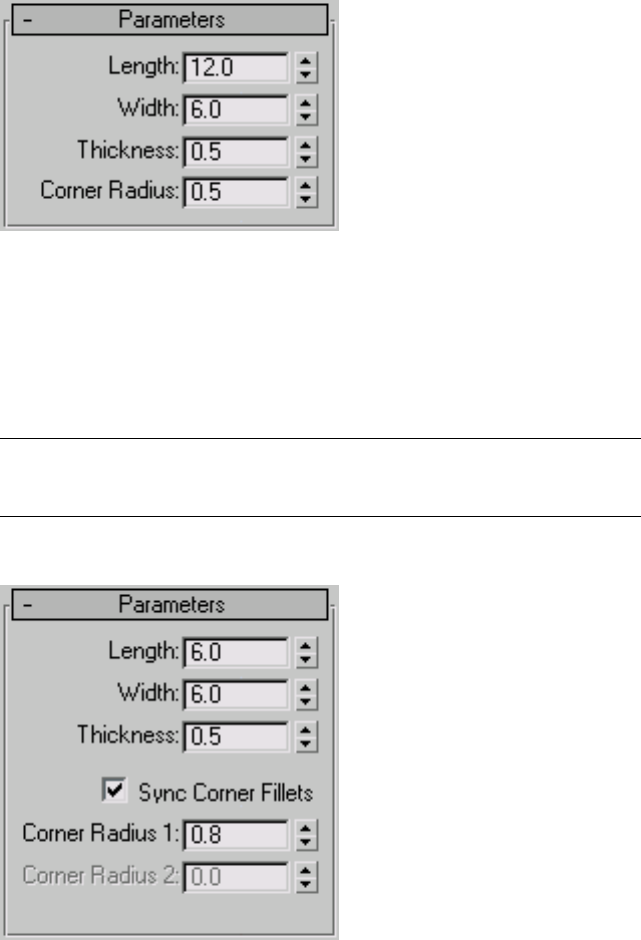
Parameters rollout – Tee
Length Controls the height of the vertical web of the tee section.
Default=12.0.
Width Controls the width of the flange crossing the tee section. Default=6.0.
Thickness Controls the thickness of the web and flange. Default=0.5.
Corner Radius Controls the radius of the two interior corners between the
vertical web and horizontal flange of the section. Default=0.5.
NOTE Be cautious when adjusting these settings. There are no constraining
relationships between them. Therefore, it's possible to set a radius (Corner Radius)
that is greater than the length of the web or width of the flange.
Parameters rollout – Tube
1720 | Chapter 9 Modifiers
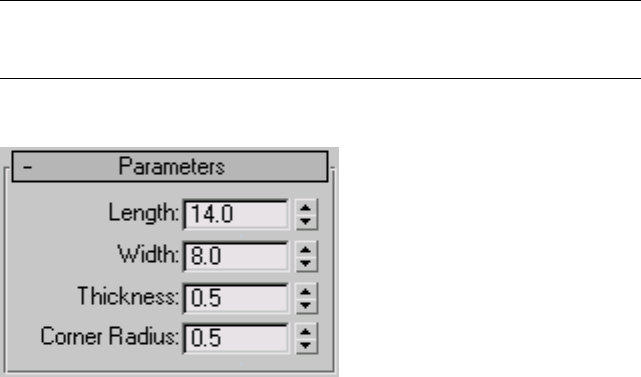
Length Controls the height of the tube section. Default=6.0.
Width Controls the width of the tube section. Default=6.0.
Thickness Controls the thickness of the walls of the tube. Default=0.5.
Sync Corner Fillets When turned on, Corner Radius 1 controls the radius of
both the interior and exterior corners of the tube. It also maintains the
thickness of the section. Default=on.
Corner Radius 1 Controls the radius of all four interior and exterior corners
of the section. Default=0.8.
If Sync Corner Fillets is turned off, Corner Radius 1 controls the radius of the
four exterior corners of the tube.
Corner Radius 2 Controls the radius of the four interior corners of the tube.
Default=0.0.
Corner Radius 2 is only available when Sync Corner Fillets is turned off.
NOTE Take care when adjusting these settings. There are no constraining
relationships between them. Therefore, it's possible to set an inside radius (Corner
Radius 2) that is greater than the length and width of the sides.
Parameters rollout – Wide Flange
Length Controls the height of the vertical web of the wide flange section.
Default=14.0.
Width Controls the width of the horizontal flanges crossing the section.
Default=8.0.
Thickness Controls the thickness of the web and flanges. Default=0.5.
Corner Radius Controls the radius of the four interior corners between the
vertical web and horizontal flanges. Default=0.5.
Sweep Modifier | 1721
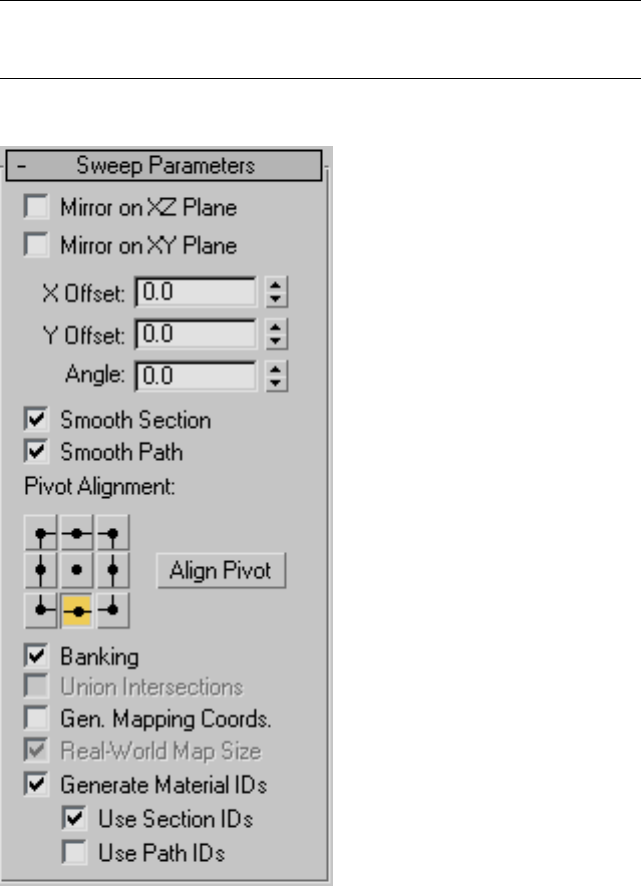
NOTE Be cautious when adjusting these settings. There are no constraining
relationships between them. Therefore, it's possible to set a radius (Corner Radius)
that is greater than the length of the web or width of the flanges.
Sweep Parameters rollout
Mirror On XZ Plane When turned on, the section is flipped vertically in
relation to the spline to which the Sweep modifier is applied. Default=off.
1722 | Chapter 9 Modifiers
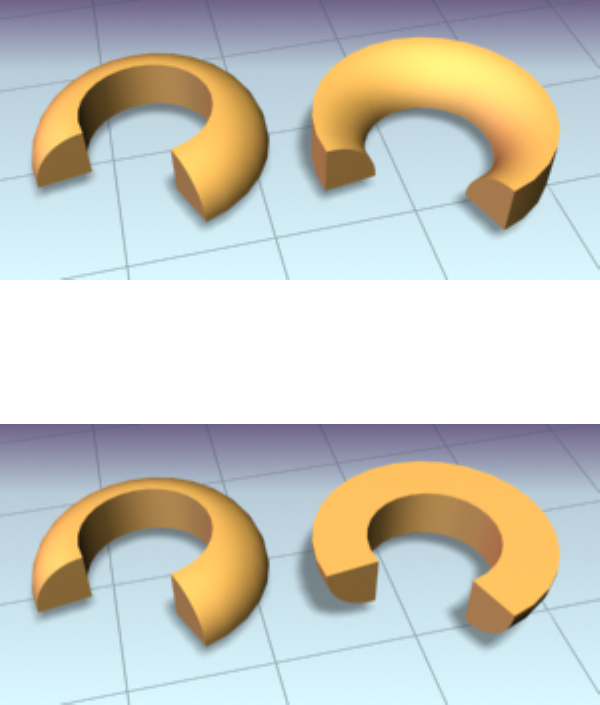
Left: The object shows the default state.
Right: The object has Mirror On XZ Plane turned on.
Mirror On XY Plane When turned on, the section is flipped horizontally in
relation to the spline to which the Sweep modifier is applied. Default=off.
Left: The object shows the default state.
Right: The object has Mirror On XY Plane turned on.
X Offset Lets you shift the horizontal position of the section relative to the
underlying spline.
Sweep Modifier | 1723
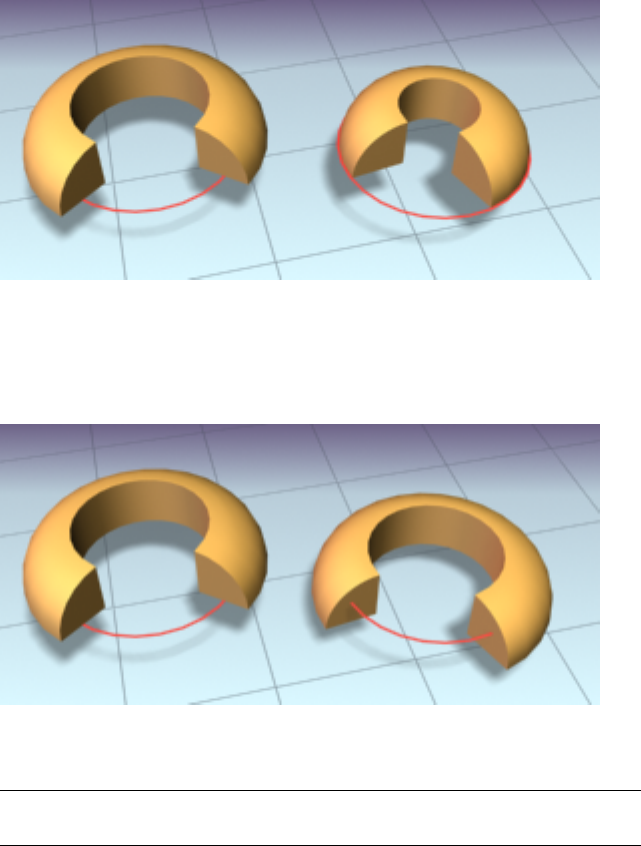
Left: The section is in the default position.
Right: The section is offset –10 relative to the underlying spline path (red).
Y Offset Lets you shift the vertical position of the section relative to the
underlying spline.
Left: The section is in the default position.
Right: The section is offset –10 relative to the underlying spline path (red).
NOTE The X and Y Offsets let you fine tune the section position while the Pivot
Alignment settings allow for a quick initial adjustment.
Angle Allows you to rotate the section relative to the plane on which the
underlying spline is located.
1724 | Chapter 9 Modifiers
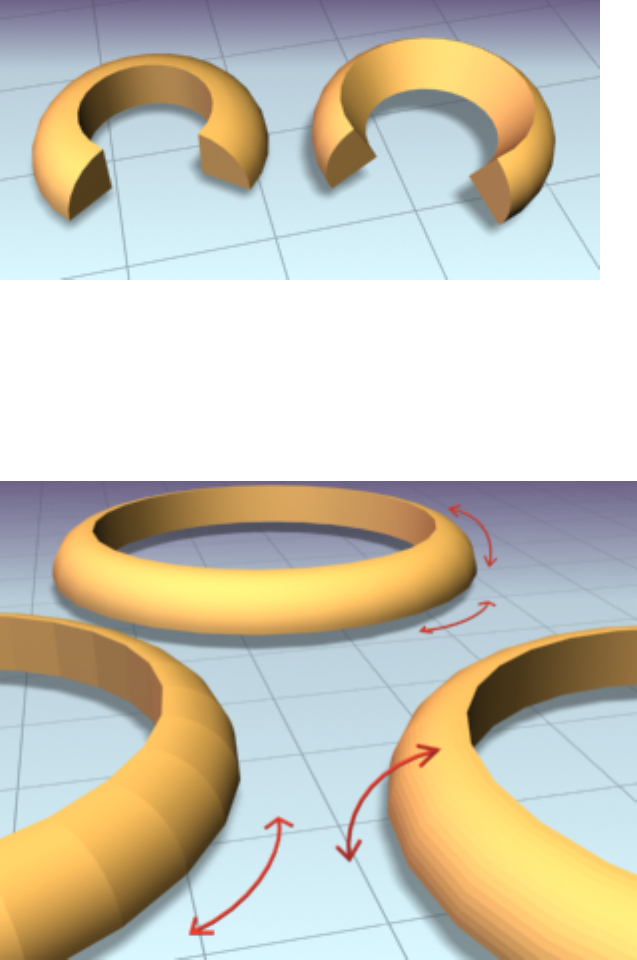
Left: The section is in the default position.
Right: The section is rotated 30 degrees.
Smooth Section Provides a smooth surface around the perimeter of the
section that is swept along the underlying spline. Default=on.
Smooth Path Provides a smooth surface along the length of the underlying
spline. This type of smoothing is useful when for curved paths. Default=off.
Left: Smoothing the path
Sweep Modifier | 1725
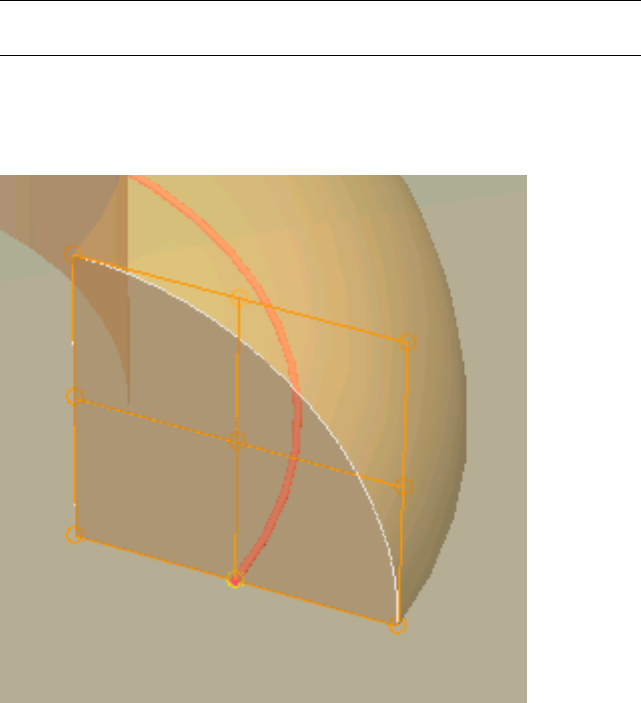
Right: Smoothing the section
Rear: Smoothing both path and section
Pivot Alignment This is 2D grid that helps you align the section to the
underlying spline path. Selecting one of the nine buttons shifts the section's
pivot around the spline path.
NOTE When none of the Pivot Alignment buttons is depressed the pivot point of
the section is used as the alignment point.
Align Pivot When turned on, a 3D representation of the Pivot Alignment
grid appears in the viewport. You only see the 3x3 alignment grid, the section
and the underlying spline path. Once you're satisfied with the alignment, turn
off the Align Pivot button or right-click to see the sweep.
Align Pivot grid showing control points (in orange) superimposed over a duplicate
sweep.
Banking When on, sections rotate about the spline path whenever the path
bends and changes height in the path's local Z axis. Banking is ignored if the
1726 | Chapter 9 Modifiers
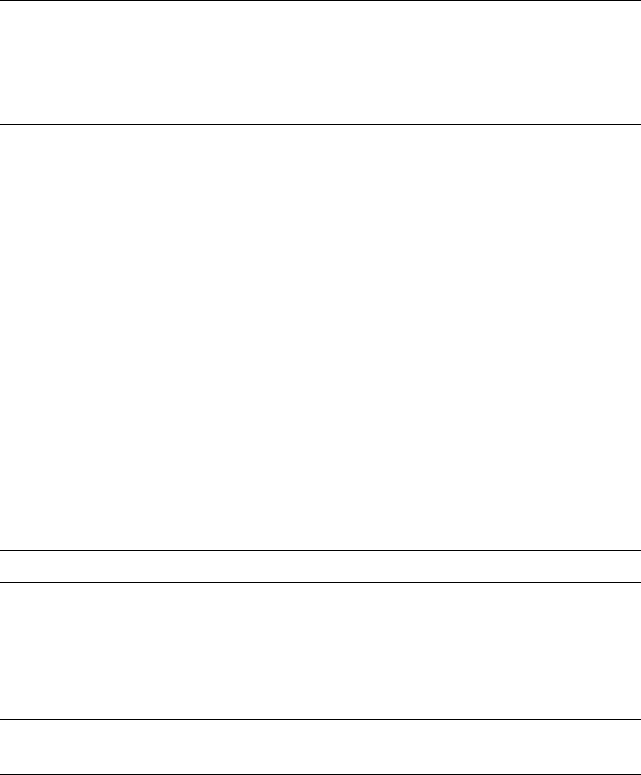
spline path is 2D. When off, shapes do not rotate about their Z axis as they
traverse a 3D path. Default=on.
Union Intersections If working with multiple intersecting splines, like a grid,
turn this switch on to produce cleaner intersections with fewer artifacts.
NOTE Union Intersections takes additional time to compute the intersections, so
leave this switch off if you don't have intersecting splines. Furthermore, this setting
will only calculate intersections of separate splines contained in one shape object.
So a figure X (separate, intersecting splines) will be properly intersected, but a
figure 8 (a single, self-intersecting spline) will not.
Gen. Mapping Coords Applies mapping coordinates to the extruded object.
Default=off.
Real-World Map Size Controls the scaling method used for texture mapped
materials that are applied to the object. The scaling values are controlled by
the Use Real-World Scale settings found in the applied material's Coordinates
rollout on page 5620 . Default=on.
Generate Mapping IDs Assigns different material IDs to the sides and the
caps of the sweep. Specifically, if both Use Section IDs and Use Path IDs are
both turned off the sides receive ID 3, the front cap receives ID 1, and the rear
cap receives ID 2. Default=on.
Use Section IDs Uses the material ID values assigned to segments of the
section that is swept along the underlying spline on page 542 or NURBS on
page 2152 curve. Default=on.
By applying an Edit Spline modifier on page 1376 to a Custom Section, different
material IDs can be assigned to each segment that makes up the section.
NOTE Built-in sections do not benefit from the Use Section IDs switch.
Use Path IDs Uses the material ID values assigned to segments of the
underlying spline or curve sub-objects in the underlying curve.
By applying an Edit Spline modifier to the underlying spline, each segment
can be assigned its own material ID.
NOTE Use Section IDs and Use Path IDs does not control the material IDs of the
front and rear caps of the sweep.
Sweep Modifier | 1727
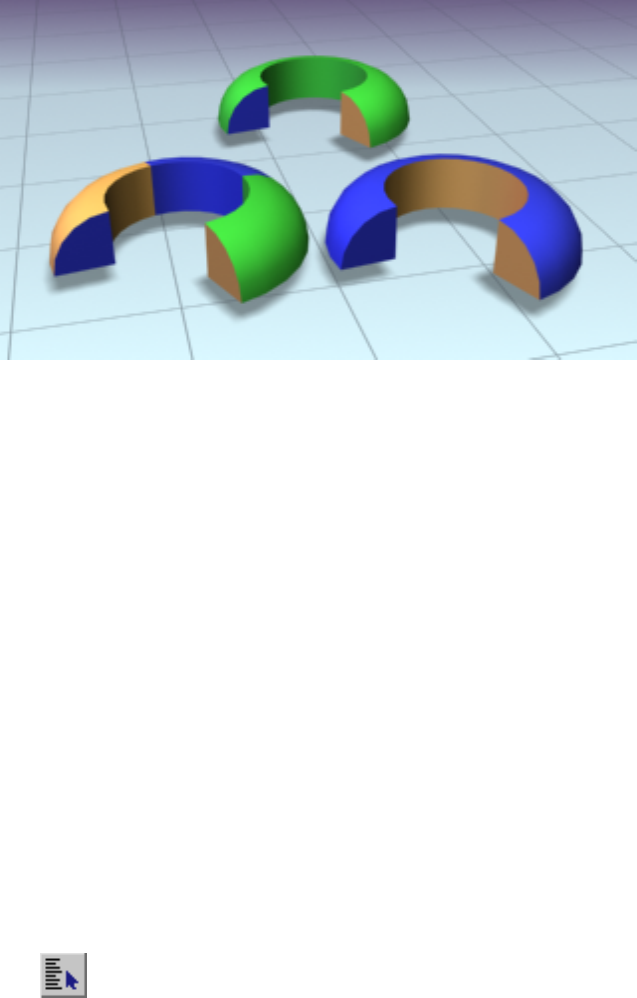
Left: Materials set by path IDs
Right: Materials set by section IDs
Rear: Section and Path IDs turned off
Pick Shape Dialog
Select a shape that already has a Sweep modifier applied. > Modify Panel >
Section Type rollout > Turn on Use Custom Section > Click Pick Shape.
The Pick Shape dialog is displayed when you select a custom shape in the
scene. This shape can be any of the splines, extended splines or NURBS curves.
Procedures
To pick a custom section using the Pick Shape dialog:
1In the viewport, pick a shape you want to use as the underlying path of
the sweep.
2From the Modifiers menu, open the Patch/Spline Editing menu and
choose Sweep.
3On the Modify panel, turn on Use Custom Section in the Section Types
rollout.
4 Click the Pick Shape button.
1728 | Chapter 9 Modifiers
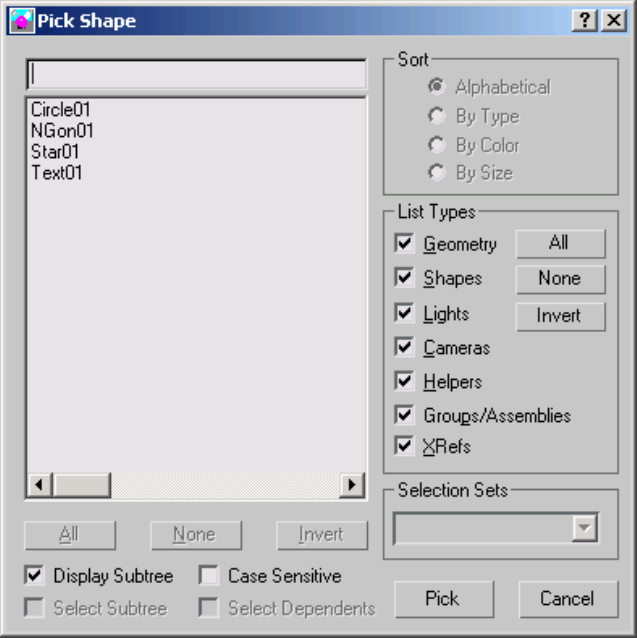
The Pick Shape dialog is displayed.
5Select a shape in the list and click the Pick button.
Interface
If the scene contains multiple shapes, you can choose only one shape to be
swept along the underlying spline in your scene.
All/None/Invert These buttons are unavailable in the Pick Shape dialog.
Display Subtree Displays the shapes in the list in an indented format. Turn
this switch off to activate the Sort group options.
Select Subtree Unavailable in the Pick Shape dialog.
Sweep Modifier | 1729
Case Sensitive When on, distinguishes between upper case and lower case
for item names.
Sort group
Options allow you to sort the list on the left. When Display Subtree is on,
these options are not available.
Alphabetical Sorts from A at the top to Z at the bottom.
By Type While this switch is available, it has no effect because only shapes
are listed in the Pick Shape dialog.
By Color Sorts by object wireframe color. The sorting order is arbitrary; shapes
of the same color are grouped together.
By Size This switch is available but has no effect on sorting.
List Types group
Because this dialog is specifically designed to work with the Sweep modifier,
the List Type group is locked to only display Shapes. Shapes is the only switch
in this group that affects what is displayed.
All/None/Invert These buttons alter the pattern of activation of the List
Types options.
Selection Sets group
The Selection Sets group is unavailable in the Pick Shape dialog.
Extract Shape Dialog
Select a shape that already has a Sweep modifier using a Custom Section
applied. > Modify Panel > Section Type rollout > Click Extract.
The Extract functionality allows you to recover custom cross-sections that
may have been deleted from the scene. As long as you have a sweep in the
scene that uses the deleted shape as a custom cross-section, Extract can be
used to restore it to the scene.
In a large scene that has many objects and shapes, you can also use Extract if
you want to quickly duplicate a section used by the sweep instead of searching
for the original shape you used as the section.
1730 | Chapter 9 Modifiers

Procedures
To extract a section from a sweep:
1In the viewport, pick a swept shape.
2Open the Modify panel and click the Extract button from the Custom
Section Types group of the Section Types rollout.
The Extract Shapes dialog is displayed.
3Enter a new name for the extracted section if you want.
4Specify the type of cloned shape you want extracted; a copy, an instance
or a reference.
5Click OK.
Interface
Name This field shows the default name that will be given to the extracted
section. By default, it always has the naming convention of
Sweep_ShapeName01, Sweep_ShapeName02, etc.
For example, if your missing section was named Roman-Ogee, the extracted
shape will be named Sweep_Roman-Ogee01.
Copy Places a copy of the extracted section at the global origin (0,0,0).
Instance Places an instance of the extracted section at the global origin.
Reference Places a reference of the extracted section at the global origin.
Merge File (Sweep Modifier)
Select a shape that already has a Sweep modifier using a Custom Section
applied. > Modify Panel > Section Type rollout > Click Merge From File.
Sweep Modifier | 1731

The Merge File dialog for the Sweep modifier appears when you click the Merge
From File button. Merge From File allows you to bring shapes or section profiles
from other scene files into the current scene.
Automatic Unit Conversion
When Respect System Units in Files is turned on in the Units Setup dialog
on page 7601 in the System Unit Scale group, merged objects from a file with
a different scene-unit scale are scaled to maintain their correct size in the new
scene.
NOTE If Respect System Units is off (which is not recommended), a 10–foot square
tube that was created in a 1 unit = 1 foot scene becomes a 10-inch square tube
in a 1 unit = 1 inch scene.
Resolving Conflicts When Merged Shapes Have the Same Name
When an incoming shape has the same name as a shape in the scene, an alert
gives you the following options:
Merge Merges the incoming shape using the name in the field at the right.
To avoid having two shapes with the same name, type a new name before
proceeding.
Skip This button is unavailable when Merge From File is used in the Sweep
modifier.
Delete Old This button is unavailable when Merge From File is used in the
Sweep modifier.
Auto Rename The merged shape's name is left intact except it is given a
numeric suffix that is one number higher than any duplicates found in the
scene.
Cancel Cancels the merge operation.
Interface
In the standard file selector dialog, select the scene file to merge. You can only
merge MAX files.
1732 | Chapter 9 Modifiers
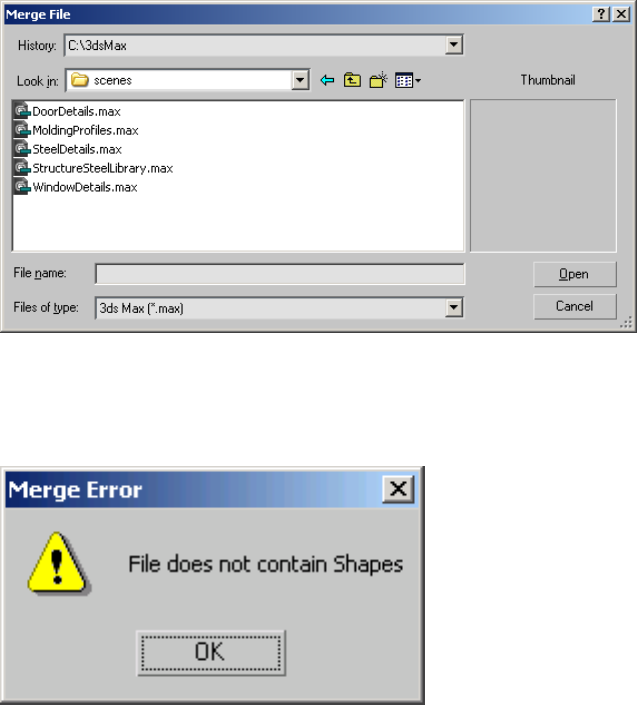
This dialog has the same functionality as the Merge File dialog on page 6854
that appears when you choose File menu > Merge with one minor exception.
If you choose a MAX file that does not include a valid 2D shape that can be
used as a custom section, you will receive a warning.
Once the scene file is selected, you can choose the shape or section profile
that you want the Sweep modifier to use.
Sweep Modifier | 1733
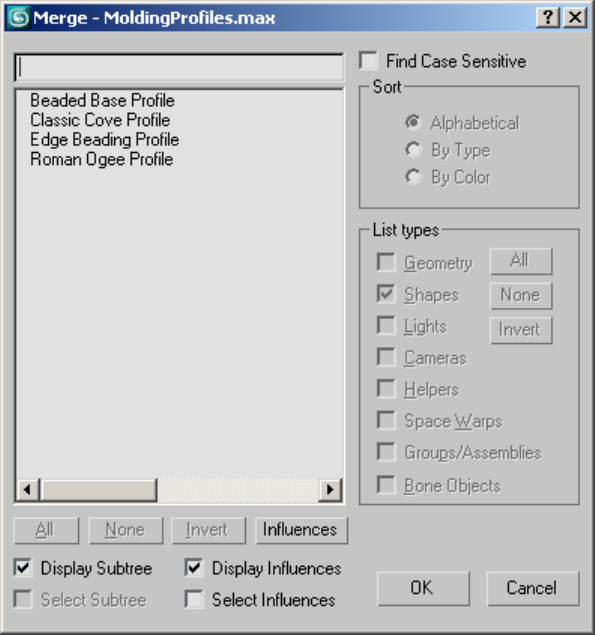
If the scene file you selected contains multiple shapes, keep in mind that you
can only choose one shape to be swept along the spline in your current scene.
All/None/Invert These buttons are unavailable when Merge From File is used
in the Sweep modifier.
Display Subtree Displays the shapes in the list in an indented format. Turn
off this option to activate the Sort group options.
Select Subtree This switch is unavailable when Merge From File is used in
the Sweep modifier.
Case Sensitive Distinguishes between uppercase and lowercase for item
names.
1734 | Chapter 9 Modifiers
Sort group
Options allow you to sort the list on the left. If the Display Subtree switch is
on, these options are not available.
Alphabetical Sorts from A at the top to Z at the bottom.
By Type This switch is unavailable when Merge From File is used in the
Sweep modifier.
By Color Sorts by object wireframe color.
List Types group
Because this dialog is specifically designed to work with the Sweep modifier,
the List Type group is locked to display only Shapes. None of the switches or
buttons in this group can be activated.
Symmetry Modifier
Modify panel > Make a selection. > Modifier List > Symmetry
Make a selection. > Modifiers menu > Mesh Editing > Symmetry
The Symmetry modifier is especially useful when modeling characters or
building ships or aircraft. This modifier is unique in that it allows you to
perform three common modeling tasks:
■Mirror a mesh about the X, Y, or Z plane.
■Slice a mesh, removing parts if necessary.
■Automatically weld vertices along a common seam.
Symmetry Modifier | 1735
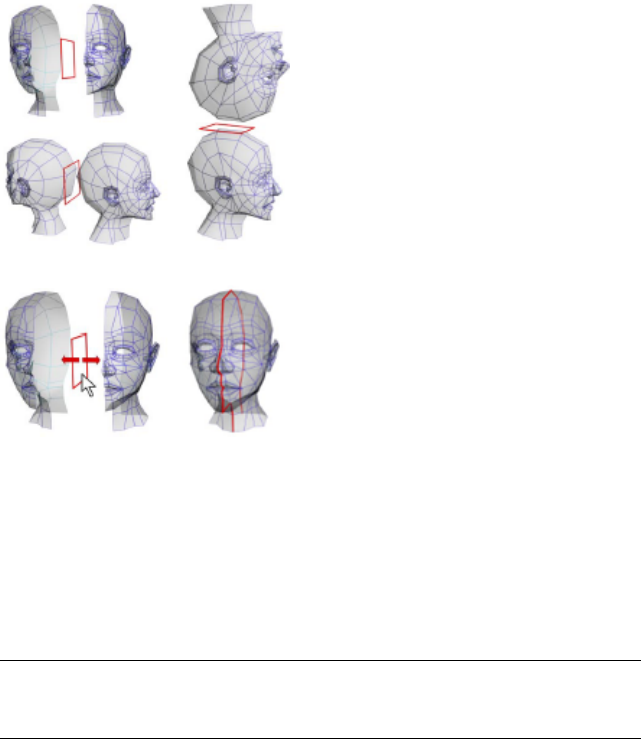
Examples of using Symmetry with different mirror axes or by moving the mirror gizmo
You can apply the Symmetry modifier to any geometry, and you can animate
the mirror or slicing effect by animating the modifier's gizmo.
When the Symmetry modifier is applied to a mesh, any edits you make to the
original half of the mesh below the Symmetry modifier in the stack also occur
interactively to the other half. For an example, see the second procedure,
below.
NOTE The Symmetry modifier converts patch and NURBS objects to mesh format
in the modifier stack; editable poly and editable mesh objects remain in their
original format.
Procedures
Example: To apply the Symmetry modifier to an object:
1Create a teapot in the Perspective viewport.
2Apply the Symmetry modifier.
The teapot appears to have two spouts.
3In the modifier stack, click the + button to see the Mirror gizmo, and
then select Mirror.
1736 | Chapter 9 Modifiers

The mirror gizmo acts as a slice plane when it is within the boundaries
of the object
4With Mirror Axis set to X, click and drag the mirror gizmo along the X
axis.
Dragging right slices more of the teapot until there is nothing visible.
Dragging left causes a second teapot to appear. When the mirror gizmo
is moved beyond the boundaries of the original mesh, it acts as a mirror
plane showing you two complete teapots.
Example: To perform box modeling with the Symmetry modifier:
1Create a box primitive in the Perspective viewport, and then convert it
to Editable Poly or apply the Edit Poly modifier.
2If necessary, press F4 to activate Edged Faces display mode in the
Perspective viewport.
3Apply the Symmetry modifier.
Other than the new edge loop created by the modifier, the box's
appearance doesn't change, because it's already symmetrical.
4In the modifier stack, click the + button to see the Mirror gizmo, and
then click Mirror.
5In the Front viewport, with Mirror Axis set to X, drag the Mirror gizmo
in either direction on the X axis.
Only the left-hand box moves; this is the copy created by the Symmetry
modifier.
6Position the Mirror near the left side of the original box, so the two copies
are merged.
7In the modifier stack, go to the Edit/Editable Poly level and access the
Vertex sub-object level.
If you no longer see the Symmetry copy of the box, turn on Show
End Result.
With Show End Result on, you might see an orange wireframe “cage”
that shows the edges of original object. This is on by default for editable
poly objects, but off by default for the Edit Poly modifier. The Show Cage
toggle for editable poly objects is on the Subdivision Surface rollout, and
for Edit Poly it's on the Edit Poly Mode rollout.
Symmetry Modifier | 1737

You can also see that only the vertices of the original object are visible;
the vertices of the symmetry object can't be transformed directly.
8Move one of the visible vertices on the right side of the box.
As you do so, its counterpart on the symmetry object moves symmetrically
in real time.
As you can see, the Symmetry modifier not only creates a mirror image
of an object for you, but also lets you manipulate both sides in tandem
in an intuitive way.
9Now move one of the vertices on the left side of the box, where it overlaps
the symmetry box.
Because you're also moving its counterpart vertex, which is invisible, the
apparent result is motion of the corresponding point on the plane of
symmetry. This isn't as intuitive as moving a non-overlapping point, so
for best results, position the Mirror gizmo so as to cause as little overlap
as possible; that way you can edit the center vertices directly on the plane
of symmetry.
Interface
Modifier Stack
Mirror The placement of the mirror gizmo delegates how the object will be
affected by symmetry. You can move or rotate, as well as animate the gizmo.
For more information on the stack display, see Modifier Stack on page 7427 .
1738 | Chapter 9 Modifiers
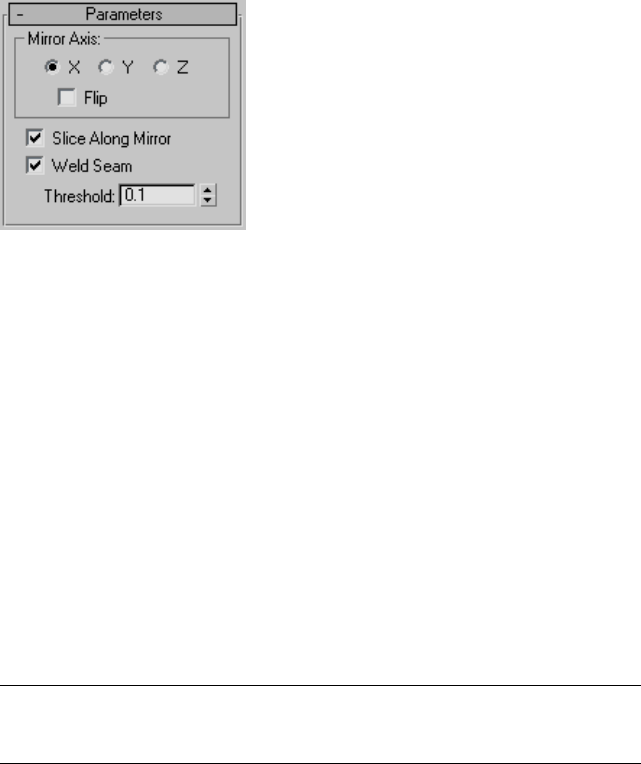
Parameters rollout
Mirror Axis group
X, Y, Z Specify the axis about which the symmetry takes place. You can see
the effect in the viewport as you select the axis.
Flip Turn on Flip if you want to flip the direction of the symmetry effect.
Default=off.
Slice Along Mirror Turning on Slice Along Mirror causes the mirror gizmo
to act as a slice plane when it in located inside the boundaries of a mesh.
When the gizmo is outside the boundaries of a mesh, the symmetrical
reflection is still treated as part of the originating mesh. If Slice Along Mirror
is turned off, the symmetrical reflection is treated as a separate element of the
originating mesh. Default=on.
Weld Seam Turning on Weld Seam assures that the vertices along the mirror
axis will be automatically welded if they are within the Threshold. Default=on.
Threshold The value of the Threshold setting delegates how close vertices
can be before being automatically welded together. Default=0.1.
NOTE Setting the Threshold value too high may result in some distortion of the
mesh, especially when the mirror gizmo is outside the boundaries of the originating
mesh.
Taper Modifier
Modify panel > Make a selection. > Modifier List > Object-Space Modifiers >
Taper
Make a selection. > Modifiers menu > Parametric Deformers > Taper
Taper Modifier | 1739
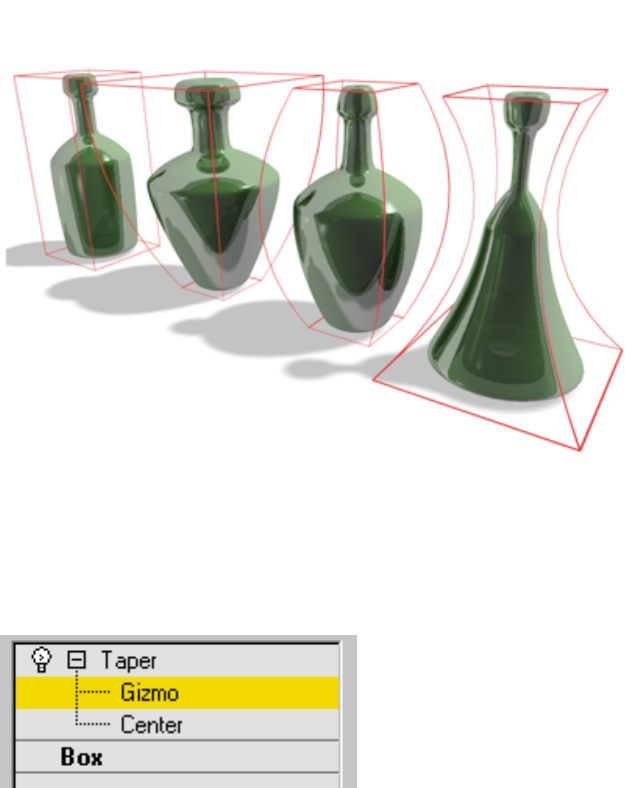
The Taper modifier produces a tapered contour by scaling both ends of an
object's geometry; one end is scaled up, and the other is scaled down. You
can control the amount and curve of the taper on two sets of axes. You can
also limit the taper to a section of the geometry.
Examples of default tapers
Interface
Modifier Stack
Gizmo At this sub-object level, you can transform and animate the gizmo
like any other object, altering the effect of the Taper modifier. Translating the
gizmo translates its center an equal distance. Rotating and scaling the gizmo
takes place with respect to its center.
1740 | Chapter 9 Modifiers
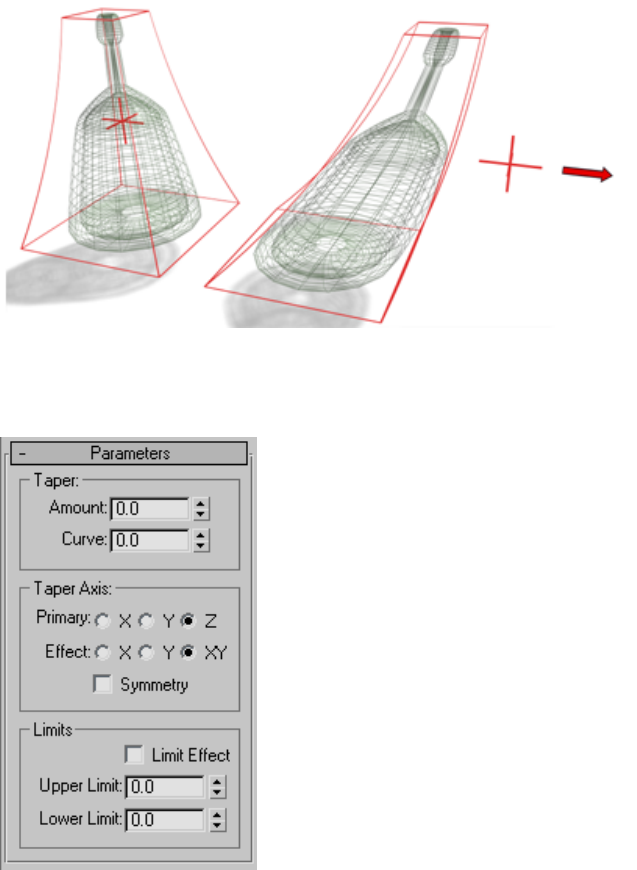
Center At this sub-object level, you can translate and animate the center,
altering the Taper gizmo's shape, and thus the shape of the tapered object.
For more information on the stack display, see Modifier Stack on page 7427 .
Moving the modifier's center changes the gizmo shape.
Parameters rollout
Taper Modifier | 1741
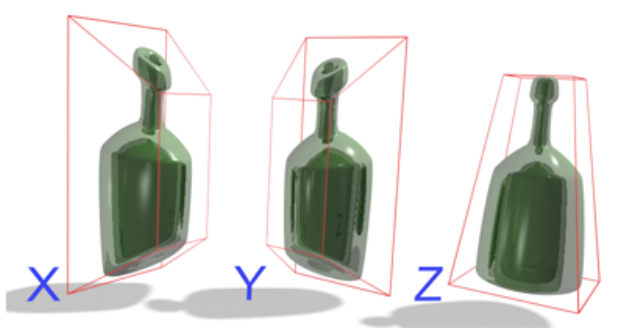
The Taper modifier provides two sets of axes and a symmetry setting in the
Taper Axis group box of the Parameters rollout. As with other modifiers, these
axes refer to the Taper gizmo, not the object itself.
Taper group
Amount The extent to which the ends are scaled. Amount is a relative value
with a maximum of 10.
Curve Applies a curvature to the sides of the Taper gizmo, thus affecting the
shape of the tapered object. Positive values produce an outward curve along
the tapered sides, negative values an inward curve. At 0, the sides are
unchanged. Default=0.
Taper Axis group
Primary The central axis or spine of the taper: X, Y, or Z. Default=Z.
Effect The axis, or pair of axes, indicating the direction of the taper from
the primary axis. The available choices are determined by the choice of primary
axis. The effect axis can be either of the two remaining axes, or their
combination. If the primary axis is X, the effect axis can be Y, Z, or YZ.
Default=XY.
Symmetry Produces a symmetrical taper around the primary axis. A taper is
always symmetrical around the effect axis. Default=off.
Changing the effect axis changes the effects of the modifier.
1742 | Chapter 9 Modifiers
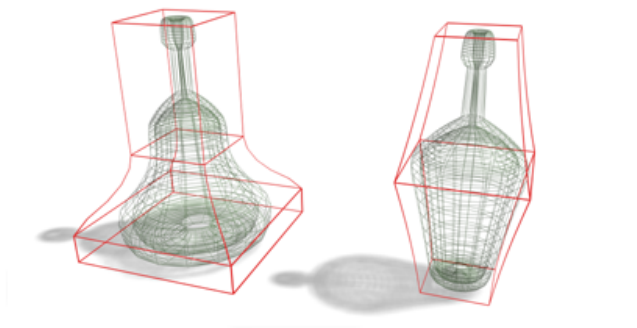
Limits group
The taper offset is applied between the upper and lower limits. The surrounding
geometry, while unaffected by the taper itself, is moved to keep the object
intact.
Limit Effect Enables upper and lower limits for the taper effect.
Upper Limit Sets the upper limit boundaries in world units from the taper
center point, beyond which the taper no longer affects the geometry.
Lower Limit Sets the lower limit boundaries in world units from the taper
center point, beyond which the taper no longer affects the geometry.
Left: Limiting the effect of the taper.
Right: Using symmetry.
Tessellate Modifier
Modify panel > Make a selection. > Modifier List > Object-Space Modifiers >
Tessellate
Make a selection. > Modifiers menu > Mesh Editing > Tessellate
The Tessellate modifier subdivides faces in the current selection. It's particularly
useful for smoothing curved surfaces for rendering, and creating additional
mesh resolution for other modifiers to act on. If no sub-object selection has
been passed up the stack, then the entire object is tessellated. This modifier
lets you tessellate polygonal faces; the tessellation available in an editable
Tessellate Modifier | 1743
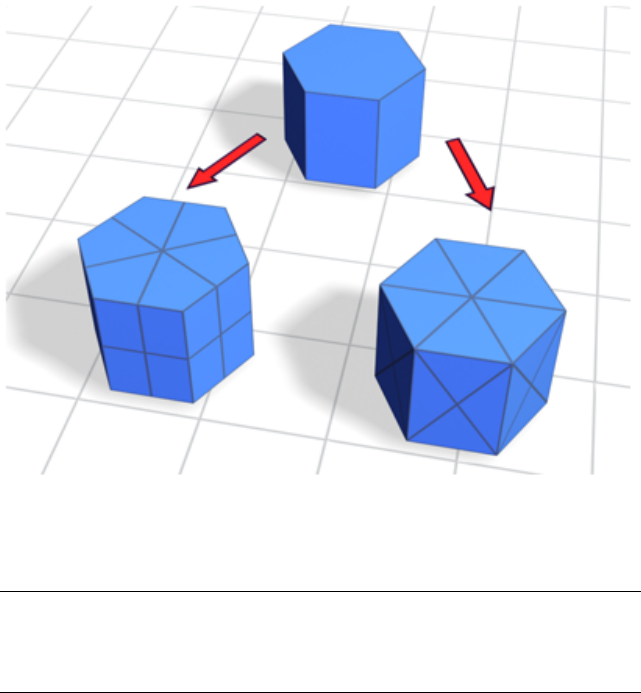
mesh on page 2014 does not (it works on faces, even at the Polygon selection
level).
Top: Original mesh object
Lower left: Tessellation applied to polygonal facets
Lower right: Tessellation applied to triangular faces
WARNING Tessellating an object retains any UVW mapping that exists in the
stack before the Tessellate modifier. However, in some cases, the mapping might
be altered, depending on the type of mapping and the tessellation settings.
Typically, this happens when the applied mapping uses extreme compound angles.
1744 | Chapter 9 Modifiers
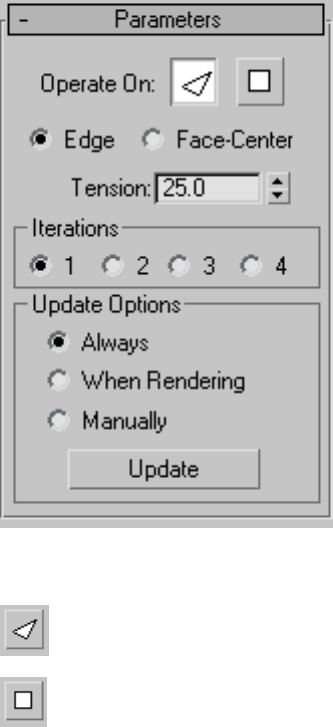
Interface
Parameters rollout
Operate On Specifies whether to perform the tessellation on the triangular
faces or on the polygonal facets (the areas bound by visible edges).
Faces Treats the selection as a set of triangular faces.
Polygons Divides the polygonal facets. For example, using the
polygonal method on the side of a box results in cross-shaped edges using the
Edge method, and X-shaped edges using the Face-Center method.
Edge Divides the face or polygon from its center to the middle of each edge.
When applied to a triangular face, it also divides unselected faces that share
edges with the selected faces.
Tessellate Modifier | 1745
Face-Center Select this to divide the face from the center to the vertex
corners.
Tension Determines if the new faces are flat, concave, or convex after Edge
tessellation. A positive value rounds faces by pushing vertices outward. A
negative value creates concave faces by pulling vertices inward. A setting of
0 keeps the faces flat. Also works with the Edge/Polygon method. Default=25.
Iterations group
Iterations Specifies how many times the tessellation is applied. For example,
setting Iterations to 2 is similar to clicking the Tessellation button twice in an
editable mesh, except that you can easily back out at any time while using
the Tessellate modifier. If you want more than four iterations, apply another
Tessellate modifier.
Update Options group
Always Tessellation is updated whenever the base geometry changes.
When Rendering Tessellation is updated only when the object is rendered.
Manually Tessellation is updated only when the user clicks Update.
Update Click to update tessellation. Has no effect unless Manually is the
active update option.
Trim/Extend Modifier
Select a shape. > Modify panel > Modifier List > Object-Space Modifiers >
Trim/Extend
Select a shape. > Modifiers menu > Patch/Spline Editing > Trim/Extend
The Trim/Extend modifier is used primarily to clean up overlapping or open
splines in a multi-spline shape so that lines meet at a single point. As with
the Fillet/Chamfer modifier, this modifier operates on the splines at the
sub-object level in the shape. When applied to a selection of multiple splines,
Trim/Extend works as it does on a single spline.
To trim, you need intersecting splines. Click the portion of the spline you
want to remove. The spline is searched along its length until it hits an
intersecting spline, and deleted up to the intersection. If the section intersects
at both ends, the entire section is deleted up to the two intersections. If the
section is open on one end and intersects at the other, the entire section is
1746 | Chapter 9 Modifiers
deleted up to the intersection and the open end. If the section is not
intersected, nothing happens.
To extend, you need an open spline. The end of the spline nearest the picked
point is extended until it reaches an intersecting spline. If there is no
intersecting spline, nothing happens. Curved splines extend in a direction
tangent to the end of the spline. If the end of a spline lies directly on a
boundary (an intersecting spline), then it looks for an intersection further
along.
Trim/Extend Modifier | 1747
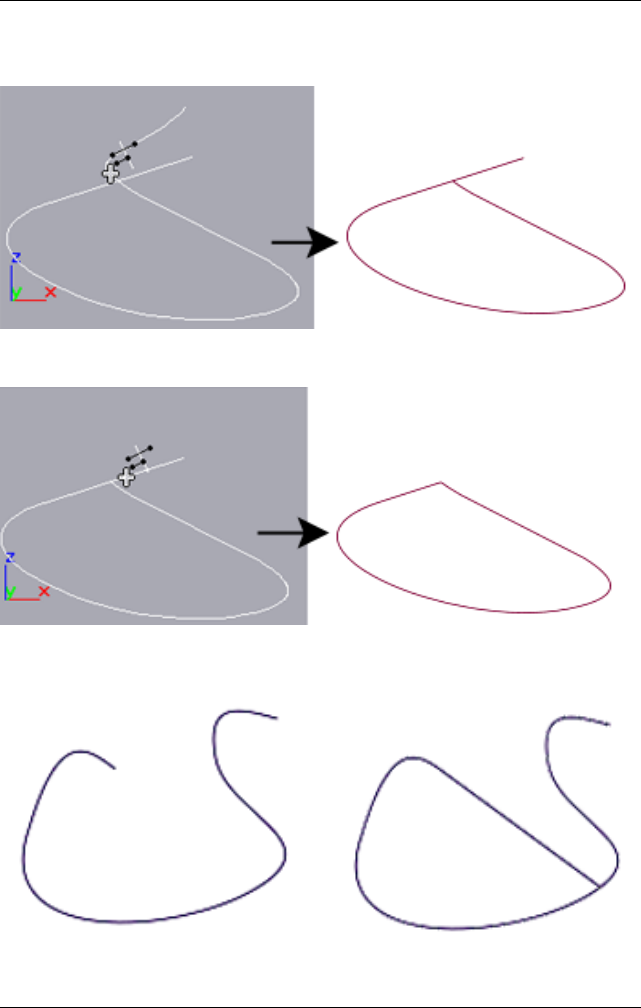
NOTE As of version 3 of 3ds Max, Edit/Editable Spline on page 590 includes
interactive trim/extend functions. The only reason to use this modifier is to apply
it at a specific location on the stack.
Before and after initial use of Trim
Before and after second use of Trim on above spline
Before and after using Extend
1748 | Chapter 9 Modifiers
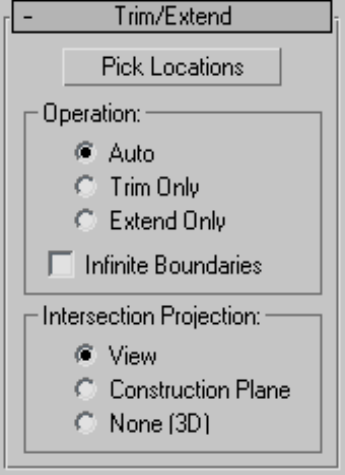
Procedures
To trim a shape using the Trim/Extend modifier:
1Create an open Line shape on page 551 in the form of roughly concentric
overlapping circles.
2Apply the Trim/Extend modifier.
3Click Pick Locations.
4Click the inner spline sections of the concentric shape to trim them away,
or click the open spline segment to extend the spline.
Interface
Pick Locations Click to turn on Pick mode. While in this mode, the mouse
cursor changes in appearance when over part of the spline that can be affected
by the Trim/Extend modifier. Click to either trim or extend the spline, based
on the settings below. Default=Auto.
Trim/Extend Modifier | 1749

Operation group
Specifies the type of operation that's performed on the selected spline.
Auto When this is chosen, a Trim is first looked for and, if not found, an
Extend is attempted. In most cases, a Trim will occur when Auto is chosen.
An Extend can occur, however, in cases where an open spline exists without
intersecting other splines.
Trim Only Performs only trims. Turn on Pick Locations, and then click the
spline section you want to trim.
Extend Only Performs only extends. Click Pick Locations, and then select
the open spline section you want to extend.
Infinite Boundaries For the purposes of calculating intersections, turn this
on to treat open splines as infinite in length. For example, this lets you trim
one linear spline against the extended length of another line that it doesn't
actually intersect.
NOTE As the number of open splines in the shape increases, the chance of finding
an intersection, when using Infinite Boundaries, increases as well. This can produce
results you might not have expected because of projected spline intersections you
hadn't considered, particularly if you're in Auto mode. For predictable results,
avoid using Auto mode when using Infinite Boundaries.
Intersection Projection group
These options specify how the Trim and Extend functions determine a valid
intersection.
View Projects the lines onto the active viewport, and judges the intersections
accordingly. These are the intersections as you see them in the active viewport.
Construction Plane Projects the lines onto the current construction plane.
None (3D) Considers only true intersections as the splines exist in 3D space.
They must physically intersect to be considered.
TurboSmooth Modifier
Make a selection. > Modify panel > Modifier List > Object-Space Modifiers >
TurboSmooth
1750 | Chapter 9 Modifiers
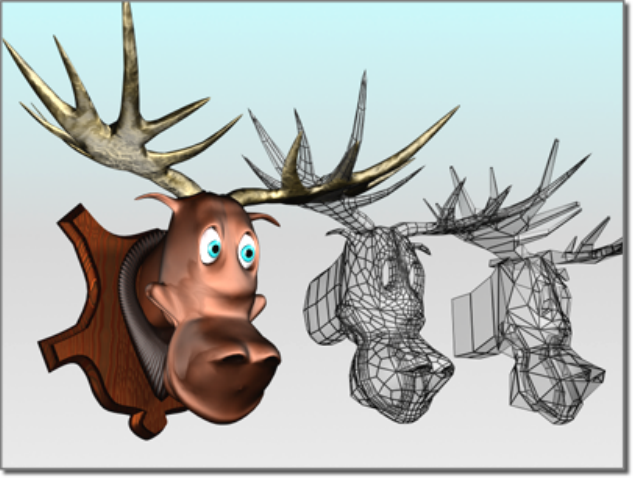
The TurboSmooth modifier, like MeshSmooth on page 1460 , smoothes geometry
in your scene. The differences between the two are as follows:
■TurboSmooth is considerably faster and more memory-efficient than
MeshSmooth. TurboSmooth also has an option for Explicit Normals,
unavailable in MeshSmooth. See Explicit Normals on page 1755 .
■TurboSmooth provides a limited subset of MeshSmooth functionality. In
particular, TurboSmooth uses a single smoothing method (NURMS), can
be applied only to an entire object, has no sub-object levels, and outputs
a triangle-mesh object.
TurboSmooth lets you subdivide the geometry while interpolating the angles
of new faces at corners and edges, and apply a single smoothing group to all
faces in the object. The effect of TurboSmooth is to round over corners and
edges as if they had been filed or planed smooth. Use TurboSmooth parameters
to control the size and number of new faces, and how they affect the surface
of the object.
Angular model (shown on the right) changed to a smooth model with TurboSmooth
TurboSmooth Modifier | 1751

You use TurboSmooth to produce a Non-Uniform Rational MeshSmooth object
(NURMS for short). A NURMS object is similar to a NURBS object in that you
can set different weights for each control vertex.
TurboSmooth's effect is most dramatic on sharp corners and least visible on
rounded surfaces. Use TurboSmooth on boxes and geometry with crisp angles.
Avoid using it on spheres and similar objects.
TIP To better understand TurboSmooth, create a sphere and a cube and apply
TurboSmooth to both. The cube's sharp corners become rounded, while the
sphere's geometry becomes more complex without changing shape significantly.
Procedures
To apply TurboSmooth to an object:
1Select an angular object.
2Apply the TurboSmooth modifier.
3Set TurboSmooth parameters.
Example: To compare the speeds of TurboSmooth and MeshSmooth:
1Create a Box primitive with Length/Width/Height Segs=3. Convert the
box to editable poly format.
2Apply MeshSmooth.
3Set Iterations=5.
This creates a heavily subdivided mesh.
4Go to the Editable Poly > Vertex sub-object level, and turn on Show End
Result.
5Move one of the corner vertices outward.
There is a significant delay before you see the result of the Move operation.
6Perform a few more Move operations on vertices, observe the delays, and
then undo (Ctrl+Z) repeatedly until the MeshSmooth modifier goes away.
7Apply TurboSmooth.
8Set Iterations=5.
This creates a heavily subdivided mesh.
1752 | Chapter 9 Modifiers
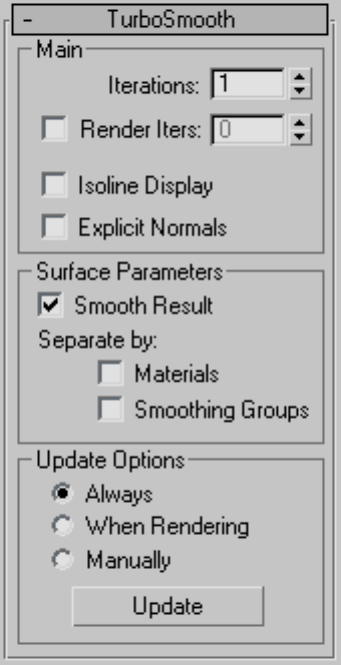
9Go to the Editable Poly > Vertex sub-object level, and turn on Show End
Result.
10 Move one of the corner vertices outward.
The response is much faster.
Interface
Main group
Lets you set the basic parameters for TurboSmooth.
TurboSmooth Modifier | 1753
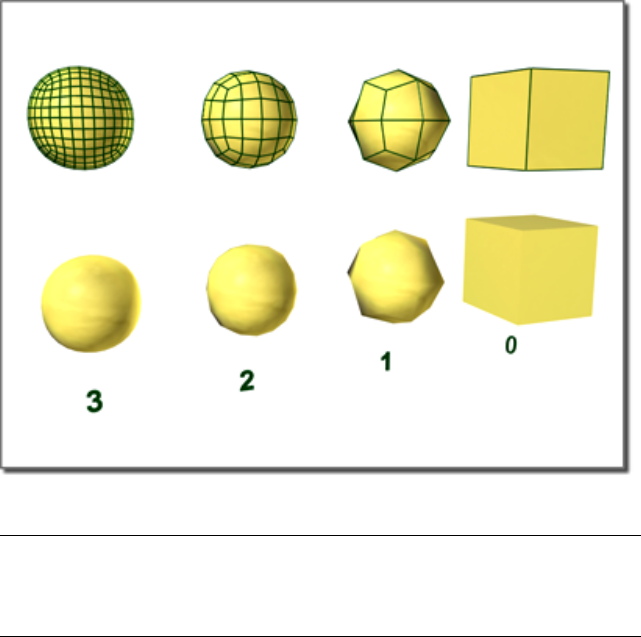
Iterations Sets the number of times the mesh is subdivided. When you
increase this value, each new iteration subdivides the mesh by creating
smoothly interpolated vertices for every vertex, edge, and face from the
iteration before. The modifier then subdivides the faces to use these new
vertices. Default=1. Range=0 to 10.
From right to left, effect of increasing the number of iterations
NOTE Be cautious when increasing the number of iterations. The number of
vertices and faces in an object (and thus the calculation time) can increase as much
as four times for each iteration. Applying four iterations to even a moderately
complex object can take a long time to calculate.
Render Iter(ation)s Lets you choose a different number of smoothing
iterations on page 1754 to be applied to the object at render time. Turn on
Render Iters, and then use the field to its right to set the number of render
iterations.
Isoline Display When on, the software displays only isolines: the object's
original edges, before smoothing. The benefit of using this option is a less
cluttered display. When off, the software displays all faces added by
TurboSmooth; thus, higher Iterations values result in a greater number of
lines. Default=off.
1754 | Chapter 9 Modifiers

WARNING If you're going to collapse the model or apply further modifiers after
the TurboSmooth, you should first turn off Isoline Display. Unlike in MeshSmooth,
isoline display is achieved by making all the edges "invisible," joining large groups
of faces together in single "polygons." This can be especially problematic if you
apply a PolyObject-based modifier afterwards, because all vertices in the interior
of these "polygons" will be lost.
Explicit Normals Lets the TurboSmooth modifier compute normals for its
output, which is faster than the standard method 3ds Max uses to compute
normals from the mesh object's smoothing groups. Default=off.
Consequently, if the TurboSmooth result is used directly for display or
rendering, it will generally be faster with this option turned on. Also, the
quality of the normals will be slightly higher. However, if you apply any
topology-affecting modifiers, such as Edit Mesh, above the TurboSmooth
modifier, these normals will be lost and new ones computed, potentially
affecting performance adversely. So it's important to remember to turn on
Explicit Normals only if no modifiers change the object topology after
TurboSmooth takes effect.
Surface Parameters group
Lets you apply smoothing groups to the object and restrict the smoothing
effect by surface properties.
Smooth Result Applies the same smoothing group to all faces.
Separate by Materials Prevents the creation of new faces for edges between
faces that do not share Material IDs.
Separate by Smoothing Groups Prevents the creation of new faces at edges
between faces that don't share at least one smoothing group.
Update Options group
Sets manual or render-time update options, for situations where the complexity
of the smoothed object is too high for automatic updates. Note that you can
also set a greater degree of smoothing to be applied only at render time, in
the Main group.
Always Updates the object automatically whenever you change any
TurboSmooth settings.
When Rendering Updates the viewport display of the object only at render
time.
TurboSmooth Modifier | 1755

Manually Turns on manual updating. When manual updating is selected,
any settings you change don't take effect until you click the Update button.
Update Updates the object in the viewport to match the current
TurboSmooth settings. Works only when you choose When Rendering or
Manually.
Turn To Mesh Modifier
Make a selection. > Modify panel > Modifier list > Object-Space Modifiers >
Turn to Mesh
Make a selection. > Modifiers menu > Conversion > Turn to Mesh
The Turn To Mesh modifier lets you apply object conversions in the modifier
stack. As another example, you could use this modifier on a sophisticated
patch model to which you might want to apply a tool that applies only to
meshes, or convert the object to a mesh. Also, when you apply general-purpose
modifiers such as Normal, Material, or UVW Map, it can be helpful to explicitly
control the type of object beforehand.
NOTE Converting from one object type to another causes a complete caching in
the modifier stack. When you have large objects in your scene, this can take up a
lot of space. For example, an object that starts as a mesh, converts to a patch, and
then back to a mesh takes three times as much space as a mesh that just has
ordinary modifiers like Bend or UVW Map applied.
TIP Turn To Mesh can be useful on meshes, allowing you to invert a selection or
change the selection level in a modifier that doesn't depend on topology.
Procedures
Example: To translate a patch sub-object selection to a polygon sub-object
selection:
1Select a patch model and turn on wireframe mode.
2In the stack display, choose the Patch sub-object level.
3Select a patch on the model.
4Apply the Turn To Mesh modifier from the Modifier list.
5In the stack display, right-click the Turn To Mesh modifier and choose
Collapse All.
1756 | Chapter 9 Modifiers
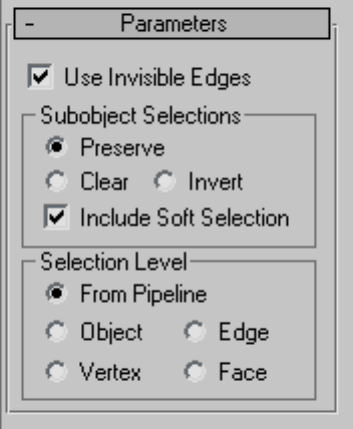
6Click Yes in the dialog that warns you about the possibility of undesirable
topological effects.
7In the stack display (or in the selection rollout), choose the Polygon
sub-object mode. The original patch selection has been preserved.
Interface
Parameters rollout
Use Invisible Edges When on, uses invisible edges to represent polygons.
When off, produces a completely triangulated mesh with all visible edges.
Default=on.
Sub-object Selections group
These options control the selection of sub-objects.
Preserve Passes the sub-object selection up the stack. For example, if you
have an object that you have converted to an editable mesh, and you've
selected a polygon, then when you apply a Turn To Mesh modifier, the polygon
remains selected. Default=on.
Clear Clears the sub-object selection so that nothing is selected. Default=off.
Turn To Mesh Modifier | 1757
Invert Inverts the sub-object selection. All sub-objects not currently selected
are selected, and all sub-objects currently selected are deselected. Default=off.
Include Soft Selection Affects the action of sub-object Move, Rotate, and
Scale functions. When these are on, 3ds Max applies a spline curve deformation
to unselected vertices surrounding the transformed selected sub-object. This
provides a magnet-like effect, with a sphere of influence around the
transformation. Use this when you want to preserve the soft selection from
beneath. For example, if Use Soft Selection is on when you select vertices on
an editable poly, and you apply Turn To Mesh with Include Soft Selection on,
then the same soft selection will apply to the mesh vertices. Default=on.
For more information, see Soft Selection Rollout on page 1926 .
Selection Level group
These options set the sub-object selection level for passing up the rest of the
stack.
From Pipeline Uses the equivalent of whatever the input object uses (patch
level becomes face level, and so on). For example, if you create a box, convert
it to an editable patch in patch mode, and apply a Turn To Mesh modifier to
it, 3ds Max passes a sub-object selection in patch mode up the stack. The Turn
To Mesh modifier takes the sub-object patch selection into account and selects
the mesh faces that derive from the patch selection.
Object Uses Object as the selection level for passing up the rest of the stack.
Edge Uses Edge as the sub-object selection level for passing up the rest of
the stack.
Vertex Uses Vertex as the sub-object selection level for passing up the rest
of the stack.
Face Uses Face as the sub-object selection level for passing up the rest of the
stack.
Turn To Patch Modifier
Make a selection. > Modify panel > Modifier List > Object-Space Modifiers >
Turn to Patch
Make a selection. > Modifiers menu > Conversion > Turn to Patch
1758 | Chapter 9 Modifiers

The Turn To Patch modifier lets you apply object conversions in the modifier
stack. Using the Turn To Patch modifier, you can fine-tune the conversion
process such as turning quads into quad patches.
NOTE Converting from one object type to another causes a complete caching in
the modifier stack. When you have large objects in your scene, this can take up a
lot of space. For example, an object that starts as a mesh, converts to a patch, and
then back to a mesh takes 3 times as much space as a mesh which just has ordinary
modifiers like Bend or UVW Map applied.
TIP Turn To Patch can be useful on patches, allowing you to invert a selection or
change the selection level in a modifier that doesn't depend on topology.
Procedures
Example: To collapse to quad patches:
1Create a chamfer box in wireframe: Create panel > Geometry > Extended
Primitives > Object Type rollout > ChamferBox button.
2Apply a Turn To Patch modifier: Modify panel > Modifier List > Turn To
Patch.
3Right-click the stack display and choose Collapse All.
Turn To Patch Modifier | 1759
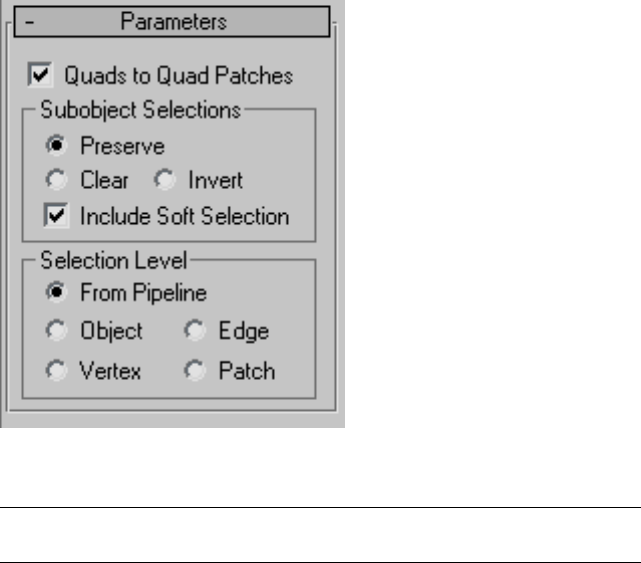
Interface
Quads to Quad Patches Turns quad faces in meshes or polymeshes into quad
patches.
NOTE When you turn this option off, 3ds Max triangulates quads when the Turn
To Patch modifier is applied to a mesh or poly object.
Sub-object Selections group
These options control the selection of sub-objects.
Preserve Passes the sub-object selection up the stack. For example, if you
have an object that you have converted from an editable mesh, and you've
selected a polygon, then when you apply a Turn To Patch modifier, the patch,
which is derived from the selected polygon, remains selected. Default=on.
Clear Clears the sub-object selection so that nothing is selected. Default=off.
Invert Inverts the sub-object selection. All sub-objects not currently selected
are selected, and all sub-objects currently selected are deselected. Default=off.
Include Soft Selection When these are on, 3ds Max applies a spline curve
deformation to unselected vertices surrounding the transformed selected
sub-object. This provides a magnet-like effect, with a sphere of influence
around the transformation. Use this when you want to preserve the soft
1760 | Chapter 9 Modifiers
selection from beneath. For example, if Use Soft Selection is on when you
select vertices on an editable mesh, and you apply Turn To Patch with Include
Soft Selection on, then the same soft selection will apply to the patch vertices.
Default=on.
For more information, see Soft Selection Rollout on page 1926 .
Selection Level group
These options set the sub-object selection level for passing up the rest of the
stack.
From Pipeline Uses the equivalent of whatever the input object uses (patch
level becomes face level, and so on.). For example, if you create a box, convert
it to an editable mesh in face mode, and apply a Turn To Patch modifier to
it, 3ds Max passes a sub-object selection in patch mode up the stack. The Turn
To Patch modifier takes the sub-object face selection into account and selects
the patches that derive from the face selection.
Object Uses object as the selection level for passing up the rest of the stack.
Edge Uses edge as the sub-object selection level for passing up the rest of
the stack.
Vertex Uses vertex as the sub-object selection level for passing up the rest
of the stack.
Patch Uses patch as the sub-object selection level for passing up the rest of
the stack.
Turn To Poly Modifier
Make a selection. > Modify panel > Modifier List > Object-Space Modifiers >
Turn to Poly
Make a selection. > Modifiers menu > Conversion > Turn to Poly
The Turn To Poly modifier lets you apply object conversions in the modifier
stack. Also, when you apply the general-purpose modifiers, such as Normal,
Material, or UVW Map, it can be helpful to explicitly control the type of object
beforehand.
When you use Turn To Poly, you're joining triangles into polygons, so you
might need to have restrictions on polygon convexity, size, and planarity. All
conversions from patches produce quads and triangles. Conversions from
Turn To Poly Modifier | 1761
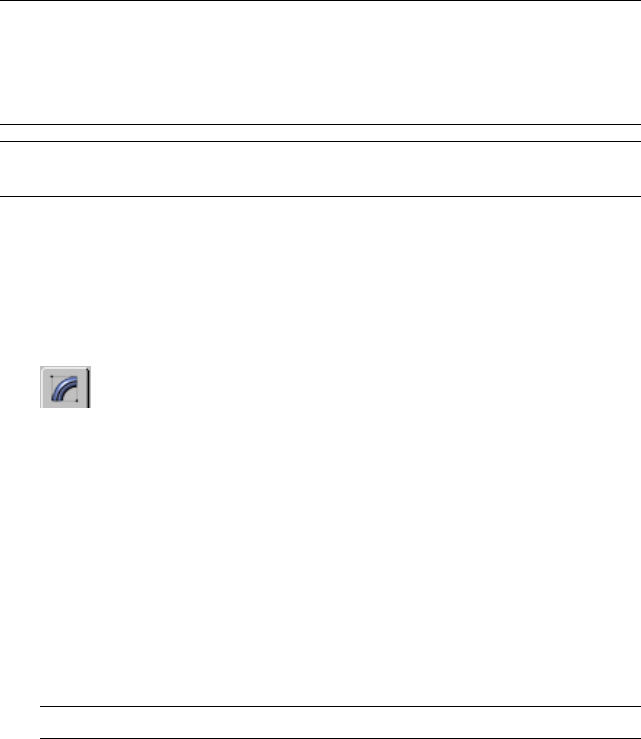
meshes can produce arbitrarily large polygons. Mesh polygons are controlled
as usual by joining together faces that are separated by invisible edges.
NOTE Converting from one object type to another causes a complete caching in
the modifier stack. When you have large objects in your scene, this can take up a
lot of space. For example, an object that starts as a mesh, converts to a patch, and
then back to a mesh takes three times as much space as a mesh that has only
ordinary modifiers like Bend or UVW Map applied.
TIP Turn To Poly can be useful on polymeshes, allowing you to invert a selection
or change the selection level in a modifier that doesn't depend on topology.
Procedures
Example: To prevent interior vertices from being passed up the stack:
1Create an NGon in wireframe mode: Create panel > Shapes > Splines >
Object Type rollout > NGon.
2 Open the Modify panel and convert the NGon to an editable mesh
by right-clicking the stack display and choosing Convert to > Editable
Mesh.
3In the stack display (or in the Selection rollout), choose the Polygon
sub-object mode.
4Choose Edit > Object Properties to display the Object Properties dialog.
5In the Display Properties group, turn off By Layer.
6Turn on Vertex Ticks. Choose OK to close the dialog.
7Click Cut under the Edit Geometry rollout, and make a cut from one side
of the NGon to the other. Notice that an interior vertex now exists.
NOTE Doing this on an NGon doesn't always generate an interior vertex.
8Apply the Turn To Poly modifier: Modify panel > Modifier List > Turn
To Poly. Notice the interior vertex clears.
1762 | Chapter 9 Modifiers
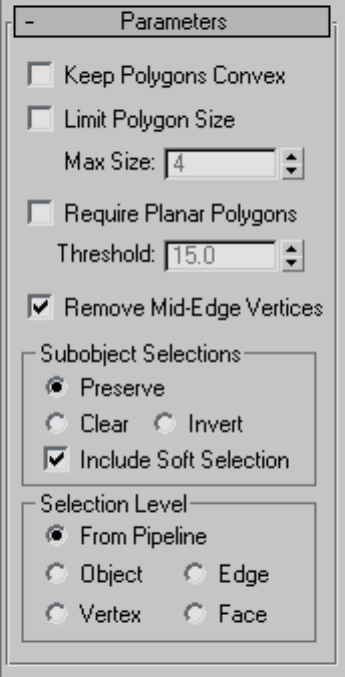
Interface
Parameters rollout
Keep Polygons Convex Does not join across edges if the resulting polygon
would not be convex. "Convex" means that you can connect any two points
in the polygon with a line that doesn't go outside the polygon. A polygon is
not convex if you can draw a line between vertices and that line lays outside
of the polygon.
Problems that can occur with non-convex polygons include the fact that
changes in the geometry of the input object can result in a different topology
for the Turn To Poly result. For instance, in a box, if you drag one of the top
corners across the middle of the top face, the box becomes non-convex. Turn
Turn To Poly Modifier | 1763
To Poly would then see this as two triangles instead of one quad, and the
number of points in the result would change.
Limit Polygon Size Limits the number of sides to a polygon so that the surface
is better defined. For example, you might want to produce a polymesh of
triangles and quads, or one composed of all triangles, rather than joining
together more than two triangles into pentagons, hexagons, and so on.
Max Size The maximum number of sides to a polygon.
Require Planar Polygons Creates polygons composed of flat planes. Does
not join faces together across an edge if the edge has a sharper angle than the
threshold listed.
Threshold Controls the threshold of the angle between polygonal planes.
Remove Mid-Edge Vertices Eliminates divisions that result from intersections
with invisible edges.
Sub-object Selections group
These options control the selection of sub-objects.
Preserve Passes the sub-object selection up the stack. For example, if you
have an object that you have converted to an editable mesh, and you've
selected a polygon, then when you apply a Turn To Poly modifier, the polygon
remains selected. Default=on.
Clear Clears the sub-object selection so that nothing is selected. Default=off.
Invert Inverts the sub-object selection. All sub-objects not currently selected
are selected, and all sub-objects currently selected are deselected. Default=off.
Include Soft Selection Affects the action of sub-object Move, Rotate, and
Scale functions. When these are on, 3ds Max applies a spline curve deformation
to unselected vertices surrounding the transformed selected sub-object. This
provides a magnet-like effect, with a sphere of influence around the
transformation. Use this when you want to preserve the soft selection from
beneath. For example, if Use Soft Selection is on when you select vertices on
an editable mesh, and you apply Turn To Poly with Include Soft Selection on,
then the same soft selection will apply to the polymesh vertices. Default=on.
For more information, see Soft Selection Rollout on page 1926 .
Selection Level group
These options set the sub-object selection level for passing up the rest of the
stack.
1764 | Chapter 9 Modifiers

From Pipeline Uses the equivalent of whatever the input object uses (patch
level becomes face level, and so on). For example, if you create a box, convert
it to an editable mesh in face mode, and apply a Turn To Poly modifier to it,
3ds Max passes a sub-object selection in face mode up the stack. The Turn To
Poly modifier takes the sub-object face selection into account and selects the
polygons that derive from the face selection.
Object Uses object as the selection level for passing up the rest of the stack.
Edge Uses edge as the sub-object selection level for passing up the rest of
the stack.
Vertex Uses vertex as the sub-object selection level for passing up the rest
of the stack.
Face Uses face as the sub-object selection level for passing up the rest of the
stack.
Twist Modifier
Modify panel > Make a selection. > Modifier List > Object-Space Modifiers >
Twist
Make a selection. > Modifiers menu > Parametric Deformers > Twist
The Twist modifier produces a twirling effect (like wringing out a wet rag) in
an object's geometry. You can control the angle of the twist on any of three
axes, and set a bias that compresses the twist effect relative to the pivot point.
You can also limit the twist to a section of the geometry.
NOTE When you apply the Twist modifier, the Twist gizmo's center is placed at
the object's pivot point, and the gizmo lines up with the object's local axis.
Twist Modifier | 1765
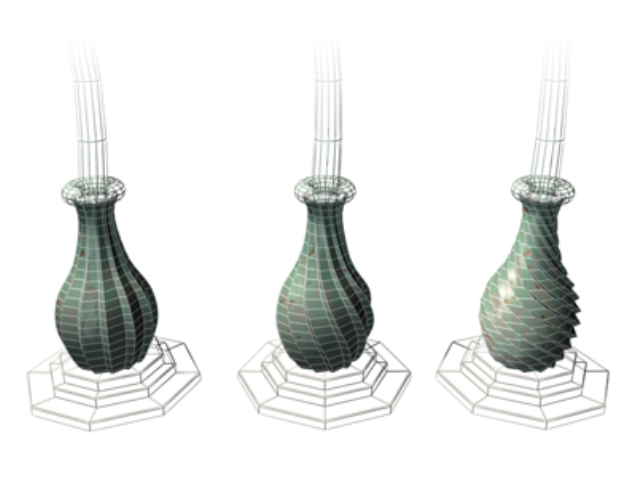
Left: Original model
Middle: A moderate twist
Right: An extreme twist
Procedures
To twist an object:
1Select an object and apply Twist.
2On the Parameters rollout, set Twist Axis to X, Y, or Z. This refers to the
axis of the Twist gizmo, not the axis of the selected object.
You can switch between axes at any time, but only one axis setting is
carried with the modifier.
3Set the angle of the twist. Positive values produce a clockwise twist,
negative values a counterclockwise twist. An angle of 360 produces a
complete revolution.
The object twists to this amount beginning at the lower limit (by default,
the location of the modifier's center).
4Set the bias of the twist.
1766 | Chapter 9 Modifiers
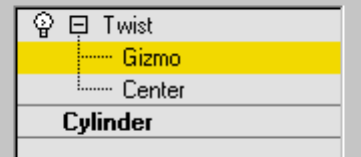
A positive value compresses the twist at the end away from the pivot
point, a negative value toward the pivot point.
To limit the twist:
1Turn on Limits group > Limit Effect.
2Set values for the upper and lower limits. These are distances in current
units above and below the modifier's center, which is at zero on the
gizmo's Z axis. The upper limit can be zero or positive, the lower limit
zero or negative. If the limits are equal, the result is the same as turning
off Limit Effect.
The twist offset is applied between these limits. The surrounding
geometry, while unaffected by the twist itself, is moved to keep the object
intact.
3At the sub-object level, you can select and move the modifier's center.
The limit settings remain on either side of the center as you move it. This
lets you relocate the twist area to another part of the object.
Interface
Modifier Stack
Gizmo You can transform and animate the gizmo like any other object at
this sub-object level, altering the effect of the Twist modifier. Translating the
gizmo translates its center an equal distance. Rotating and scaling the gizmo
takes place with respect to its center.
Center You can translate and animate the center at this sub-object level,
altering the Twist gizmo's shape, and thus the shape of the twisted object.
For more information on the stack display, see Modifier Stack on page 7427 .
Twist Modifier | 1767
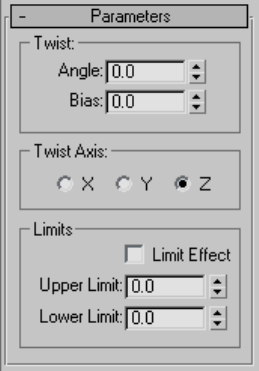
Twist Parameters rollout
Twist group
Angle Determines the amount of twist around the vertical axis. Default=0.0.
Bias Causes the twist rotation to bunch up at either end of the object. When
the parameter is negative, the object twists closer to the gizmo center. When
the value is positive, the object twists more away from the gizmo center. When
the parameter is 0, the twisting is uniform. Range=100 to -100. Default=0.0.
Twist Axis group
X/Y/Z Specify the axis along which the twist will occur. This is the local axis
of the Twist gizmo. Default=Z.
Limits group
Applies the twist effect only to vertices that lie between the lower and upper
limits. The two spinners represent distance along the gizmo's Z axis (Z=0 is at
the gizmo's center). When they are equal, it is the same as disabling the twist
effect.
Limit Effect Applies limit constraints to the Twist modifier.
Upper Limit Sets the upper limit for the twist effect. Default=0.
Lower Limit Sets the lower limit for the twist effect. Default=0.
1768 | Chapter 9 Modifiers

Unwrap UVW Modifier
Select one or more objects. > Modify panel > Modifier List > Object-Space
Modifiers > Unwrap UVW
Select one or more objects. > Modifiers menu > UV Coordinates > Unwrap
UVW
The Unwrap UVW modifier lets you assign mapping coordinates to sub-object
selections, and to edit the UVW coordinates of those selections. You can also
use it to unwrap and edit existing UVW coordinates on an object. Maps can
be adjusted to the proper fit on a Mesh, Patch, Polygon, HSDS, or NURBS
model.
The Unwrap UVW modifier can be used as a self-contained UVW mapper and
UVW coordinate editor, or in conjunction with the UVW Map modifier on
page 1849 . If you use Unwrap UVW in conjunction with the UVW Map modifier,
it is usually so you can use a mapping method unavailable in Unwrap UVW,
such as Shrink Wrap. You can animate UVW coordinates by turning on the
Auto Key button and transforming the coordinates at different frames.
NOTE After applying the Unwrap UVW modifier, open mapping edges, or seams,
appear on the modified object in the viewports. This helps you visualize the
locations of mapping clusters on the object surface. You can toggle this feature
and set the line thickness with the Display setting on page 1783 .
Unwrap UVW Modifier | 1769
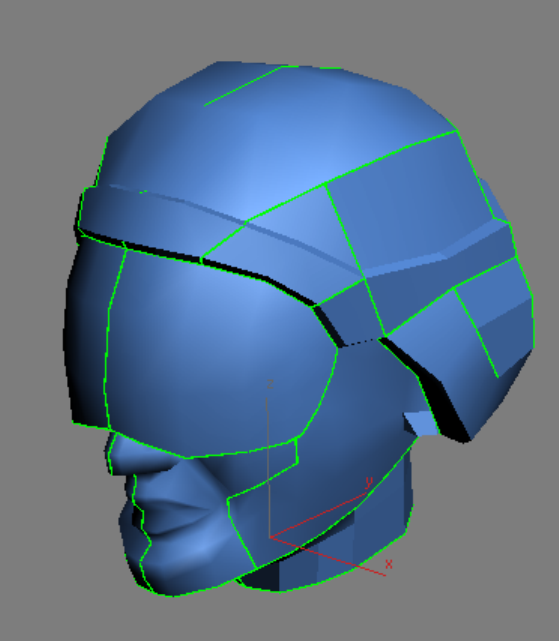
Open UVW mapping edges (seams) shown on head model in viewport
Self-Contained Mapper and UVW Coordinate Editor
Rather than creating a large modifier stack by first making a sub-object selection
of faces and then adding a UVW Map modifier to specify the type of mapping,
you can use the Unwrap UVW modifier to do both. You can select sub-object
vertices, edges, or faces/patches, store sub-object selections as named selections,
map them using planar and other methods , and then edit the UVW
coordinates for each sub-object selection, all from within the Unwrap UVW
modifier. For example, to map a character's face using three planar maps, you
could create three sub-object selections of the front and sides of the face,
planar-map the selections individually, and then edit the UVW coordinates
for each selection, all without leaving the Unwrap UVW modifier.
1770 | Chapter 9 Modifiers
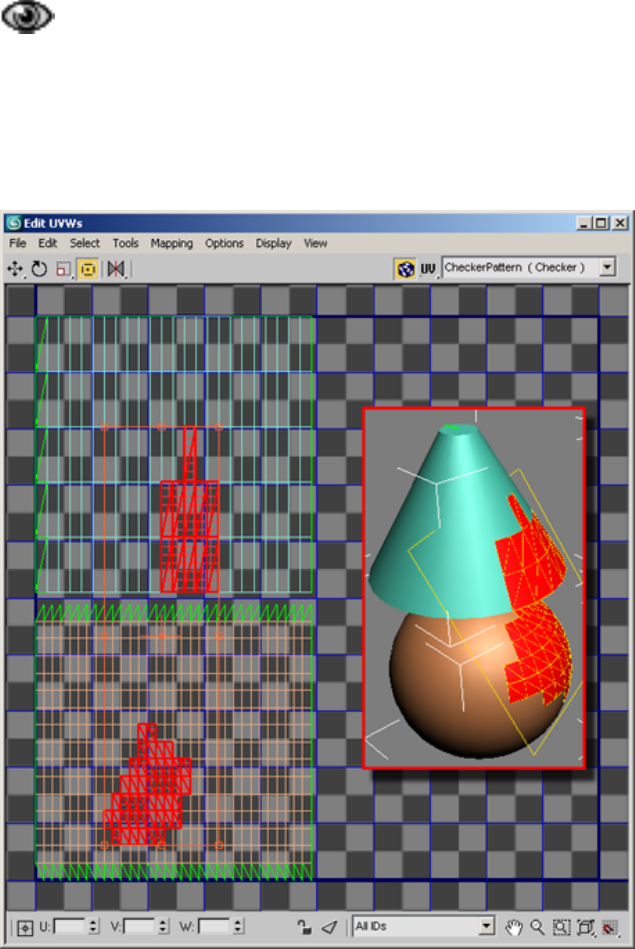
Support for Multiple Unwrap Objects
New instancing capabilities in Unwrap UVW make it easy to map a texture
across several objects. You simply make your selection and then apply Unwrap
UVW. When you open the editor, you’ll see the mapping coordinates for all
selected objects containing the instanced modifier. The editor shows each
object’s wireframe color on page 7423 so you can distinguish the different
objects.
Left: Two objects’ UVW coordinates in the editor, showing wireframe colors.
Unwrap UVW Modifier | 1771

Right (inset): The objects with a shared Unwrap UVW modifier in the viewport.
TIP The UVWs of different objects typically start out in the same location in the
editor, so it’s a good idea to separate them before editing. To save time, use the
Pack UVs function on the Tools menu.
What Happens to Existing UVW Coordinates
When you apply the Unwrap UVW modifier, it stores the object's current
mapping coordinates in the modifier. If the object has no mapping coordinates,
the modifier creates new ones by applying planar mapping. If the incoming
data on the stack is a face-level or polygon-level sub-object selection, then
only the UVWs for the selected faces are brought into the modifier, and the
modifier's sub-object levels are unavailable.
When the modifier is evaluated, its UVWs are reassigned to the object flowing
down the pipeline. So if the UVWs upstream are changed, the changes won't
make it past the Unwrap UVW modifier. If the Unwrap modifier is operating
on a selection of faces, then upstream changes to unselected faces will still be
able to flow past the Unwrap modifier.
Native Support for HSDS, Polygon Object, and Patch mapping
Unwrap UVW supports polygon faces and Bezier quad and tri patch faces in
addition to triangles and quads.
Below is a sample of what the various face types look like based on the
incoming type. For HSDS and Poly surfaces, the basic interface remains the
same, except that the maximum number of sides per polygon increases from
4 to over two billion. HSDS supports only one level of detail: the level at which
the mapping was. Patches have handles on nonlinear vertices. These handles
work just like regular patch handles.
1772 | Chapter 9 Modifiers
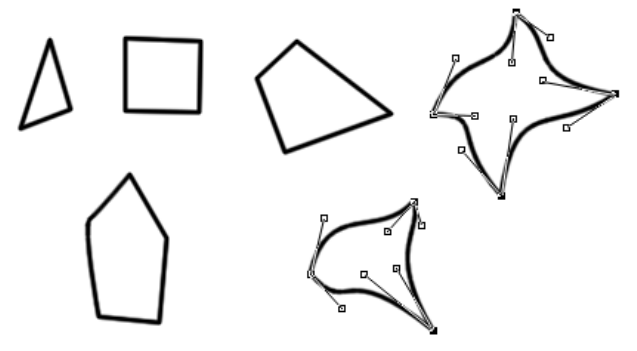
Pinning Textures
Although not its primary purpose, you can use the Unwrap UVW modifier to
freeze UVWs. You can apply mapping after an animated deformation and
have the mapping stick to the object. For example, you can apply Unwrap
UVW above a Morpher modifier in the modifier stack, apply planar maps and
edit the UVW coordinates. The mapping will follow the morphing geometry.
Procedures
To use Unwrap UVW with the non-Pelt mapping methods:
This is a general overview of using the basic Unwrap UVW tools available on
the Modify panel and the Edit UVWs dialog on page 1788 . Unwrap UVW
provides many additional tools, particularly in the editor.
1Apply the modifier and a texture-mapped material to an object. Set the
material to display in the viewports, set at least one viewport to be shaded
(e.g., press F3 to toggle between Wireframe and Smooth+Highlights), and,
if necessary, turn off Shade Selected Faces (press F2) for that viewport so
the texture mapping is visible.
2Go to the Face sub-object level of the Unwrap modifier and make a
selection of contiguous faces. You'll use a single mapping type on this
selection.
Within the single modifier, you can apply as many different mappings
as you like to different face selections.
Unwrap UVW Modifier | 1773
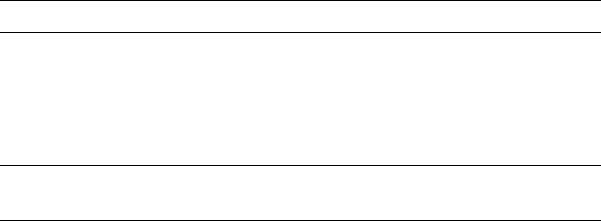
3It is recommended that you name the selection using the Named
Selection Sets on page 179 function on the main toolbar. This makes it
easy to return to the selection set in the viewports for subsequent mapping
adjustments. For example, if you're working on a house, you could use
names such as roof.
IMPORTANT Be sure to press Enter after typing the selection set name.
4On the Map Parameters rollout, click the appropriate mapping type button
(Planar, Box, etc.) and then adjust the gizmo using any combination of
the transform tools (Move, Rotate, Scale) in the viewports and the Align
buttons (Align X, etc.) on the Map Parameters rollout.
TIP You can often save time by starting with the Best Align command and
then adjusting manually from there.
After each adjustment of the mapping gizmo, the texture display in the
viewports updates to reflect the mapping changes, as do the green seam
lines on the object that show where the open edges lie (depending on
the object shape and mapping type; the seam lines don't change with
Planar mapping). To cause the viewports to update in real time, turn on
Edit UVWs dialog > Constant Update on page 1799 .
You can also open the editor (Parameters rollout > Edit) to view the
changes in the generated texture coordinates as you adjust the gizmo.
5Click the mapping type button again to turn it off and exit mapping for
this face selection.
6Continue making and naming selections and applying mapping until
the entire mesh is mapped. Use the green seam display lines as a guide.
If you don't see them, make sure Parameters rollout > Display Group >
Thin Seam Display or Thick Seam Display is active.
7Open the Edit UVWs dialog on page 1788 (Parameters rollout > Edit).
By default, the editor displays a checkered background. To view the map
in the material on the object, you need to change a setting.
8At the right end of the editor upper toolbar, click the drop-down list that
currently reads CheckerPattern (Checker) and choose the map that's
applied to the material.
The map appears as the background.
By default, all the UVW clusters display. To work on one cluster at a time,
you need to filter the UVWs.
1774 | Chapter 9 Modifiers

9 On the Edit UVWs dialog > lower toolbar, click Filter Selected Faces.
At this point, only faces you select in the viewport will appear in the
editor. You can select them directly, or choose a named selection set. In
the next step, you'll use the latter method.
10 On the main toolbar, open the Named Selection Sets drop-down list, and
choose one of your named selection sets.
The viewports show the selection as active, and the UVW coordinates
for the selection appear in Edit UVWs window.
11 In the Edit UVWs window, select and move a UVW face.
In the viewports, the texture slides around the selected portion of the
object mesh.
12 Choose a different selection set and edit its UVW coordinates.
Again, the viewport display reflects the editing changes.
13 In a viewport, drag to select a group of faces by region.
The faces' UVW coordinates display in the Edit UVWs window. This is
another way of choosing what you want to work on.
As you can see, from within the Unwrap UVW modifier you can assign
multiple mapping types to different, named face selections, and then
edit the UVW coordinates to fine-tune map placement on the geometry.
To perform quick planar mapping:
You'll find the Quick Planar Map controls on the Map Parameters rollout of
the Unwrap UVW modifier.
1Apply Unwrap UVW to an object.
2Go to the Face sub-object level.
3Select the faces to map.
The Quick Map gizmo appears juxtaposed over the face selection, showing
the default Averaged Normals mapping.
4If you prefer a different orientation for the mapping, choose X, Y, or Z.
5Click Quick Planar Map to apply the mapping. To map additional faces,
proceed from step 3.
Unwrap UVW Modifier | 1775
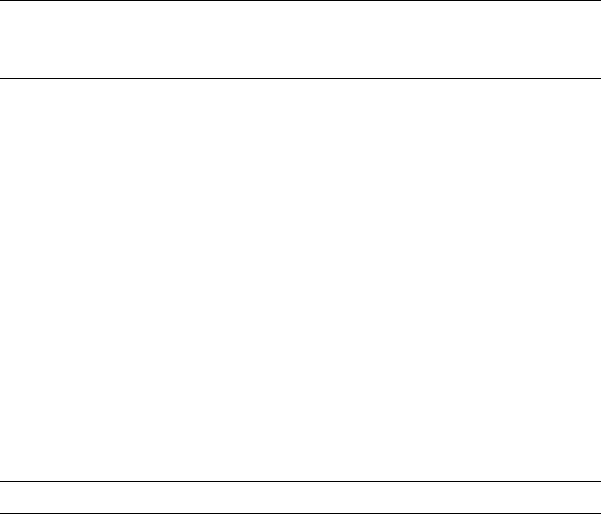
To use Pelt mapping:
Pelt mapping on page 1785 is useful for mapping organic models such as
characters and creatures. This feature gives you a special editor with a virtual
stretcher and springs that let you easily “pull” a complex UVW map flat. The
result more closely approximates the actual shape of the object than other
mapping methods, making it easier to create convincing texture maps.
1Apply Unwrap UVW to the object.
2Make an edge selection that you can later convert to pelt seams. It's not
absolutely necessary to do this at this point, but the Edge sub-object level
of the modifier gives you handy Ring and Loop tools as well as buttons
to expand and shrink the edge selection automatically.
TIP Creating the pelt seams is more art than exact science. Visualize the way
the mesh should lie flat, and then select edges so the UVs can split in a natural
way.
3Go to the Face sub-object level of the modifier and select the faces to pelt
map. To select all faces, press Ctrl+A. If you're not pelt-mapping the entire
mesh, you can skip this step.
4If you made an edge selection in step 2, click Map Parameters rollout >
Edge Sel To Pelt Seams. This copies the edge selection to pelt seams. If
you didn't specify the pelt seams at the Edge sub-object level of the
modifier, turn on Edit Seams or Point To Point Seam and then specify
seams in the viewports.
The pelt seams appear on the mesh as blue lines.
5If you're not pelt-mapping the entire mesh, you probably want to map
a region enclosed by a pelt seam. Click a face within the region to map
and then click Exp. Face Sel to Pelt Seams.
This expands the face selection to the full size of the region defined by
the pelt seam.
NOTE You can pelt map only one such region at a time.
6Turn on Pelt, and then adjust the planar map gizmo the way you want.
You can do so manually or automatically with one of the Align buttons
on the Map Parameters rollout. For a vertical humanoid character facing
the Y axis, try using the Align X button. The ideal result in the Edit UVWs
dialog (see step 7) is an outline of the object as viewed from the front or
back.
1776 | Chapter 9 Modifiers
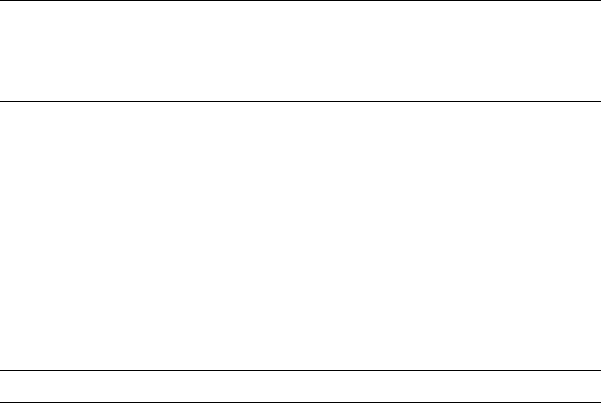
TIP For best results with cylindrical areas such as limbs, align the plane at
right angles to the seam of the area to pelt map. For example, if the seam
runs down the back side of a leg, orient the plane along a line running from
the right side to the left side of the leg.
7On the Map Parameters rollout, click Edit Pelt Map.
This opens the Edit UVWs dialog, if necessary, and displays the pelt UVWs
and the stretcher in the editor window. By default, the stretcher appears
as a circle of points centered on the pelt UVWs, with only the stretcher
vertices selected. Also, springs, represented as dashed lines, connect the
stretcher points and the pelt-seam vertices.
8If necessary, rotate the Pelt UVs so that the mapping coordinates are
oriented correctly, and rotate the stretcher so that the springs form a
symmetrical pattern. Typically you're looking for left-right symmetry.
TIP Using Ctrl+click adds to the existing selection, as in the viewports.
9On the Pelt Map Parameters dialog, click Simulate Pelt Pulling.
The springs contract, pulling the pelt seam vertices toward the stretcher
points. The internal UV vertices are also affected by this action. You can
adjust the extent to which they're affected with the Decay setting.
10 Continue adjusting the stretcher points, mapping vertices, dialog settings,
etc., and re-running the solution until you get the desired results. If things
get out of hand, simply undo, or click Reset Stretcher and start over.
To export texture coordinates to a paint program:
1Apply the Unwrap UVW modifier to your object and use the modifier
tools to set up the mapping. Texture-coordinate clusters that will use the
same texture area should overlap.
2From the Edit UVWs dialog menu bar, choose Tools > Render UVW
Template.
This opens the Render UVs dialog:
Unwrap UVW Modifier | 1777
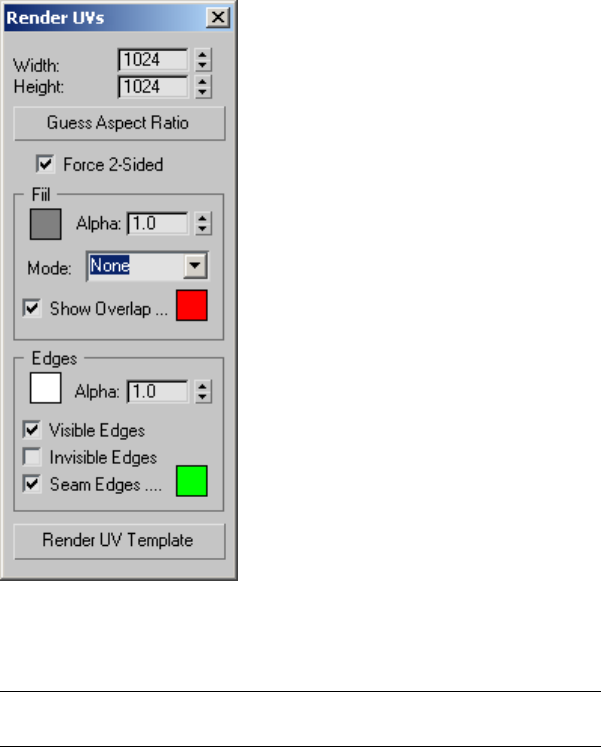
3Set the Width and Height values to the output resolution you want in
the rendered template. You'll usually get good results by setting the desired
width and then clicking Guess Aspect Ratio.
TIP When creating texture maps for gaming and other real-time 3D engines,
be sure to set both dimensions to powers of 2: 256, 512, 1024, etc.
4Change the remaining values as needed. By default, the template is
rendered with the edges as white and opaque (alpha=1.0), and background
is empty and transparent (background alpha=0.0), but you have a variety
of choices here, as detailed in Render UVs Dialog on page 1835 .
5At the bottom of the dialog, click Render UV Template.
This opens a new rendered frame window on page 5885 containing the
rendered template as a bitmap. Inspect the output, and if changes are
necessary, make them on the Render UVs dialog and re-render.
1778 | Chapter 9 Modifiers

6 When you're satisfied with the results, click Save Bitmap on the
rendered frame window toolbar, and then use the file dialog to specify
the file type and name. Click Save to export the file.
If you want to use the rendered transparency information in the paint
program, be sure to save in a format that supports the alpha channel,
such as TIF or Targa.
7Open the exported image in a paint program and use the rendered edges
as a guide for painting the texture map. Save the image when done.
Be sure to paint over or erase all the edges so they don't appear in the
final texture.
8Back in 3ds Max, create a material, set the Diffuse map to Bitmap, and
open the file from the previous step.
9Apply the material to your mesh object.
The painted texture map follows the outlines set up by the exported UVs.
Interface
After applying the modifier, its panel appears, consisting of the modifier stack
plus two rollouts:
Modifier Stack display
Normally, when you apply Unwrap UVW to an object, the modifier stack
provides access to Vertex, Edge, and Face sub-object levels. These are
synchronized with the corresponding selection modes on the Edit UVWs
dialog on page 1788 . The Vertex and Edge sub-object levels are useful for making
UVW vertex and edge selections in the viewports, where texture mapping on
Unwrap UVW Modifier | 1779
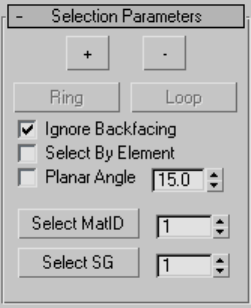
the object surface is more readily visible, and the Edge level is also useful for
setting up edge selections that you can later convert to pelt seams.
If you apply Unwrap UVW to an active face selection of an Editable/Edit
Mesh/Poly object, or to an active patch selection of an Editable/Edit Patch
object, no sub-object levels are available in the Unwrap UVW modifier. You
can use Unwrap UVW to edit only the selection that was active when you
applied the modifier. Changing the sub-object selection in the object doesn't
affect the Unwrap modifier contents, because the modifier obtains the face
selection when you first apply it.
All three sub-object levels are synchronized between the modifier stack and
the Selection Modes group on page 1796 on the Edit UVWs dialog. When you
activate a sub-object level in one, it's also activated in the other. Similarly,
selecting sub-objects in a viewport selects them in the editor and vice-versa.
Selection Parameters rollout
Use these settings to make or modify a sub-object selection for use by the
modifier. If you've passed a face selection up the stack, for example from the
Poly Select modifier, Unwrap UVW uses that instead, and makes these controls
unavailable.
+ button Expands the selection by selecting all faces adjacent to selected
faces.
- button Reduces the selection by deselecting all faces adjacent to
non-selected faces.
Ring Expands an edge selection by selecting all edges parallel to the selected
edges. Ring applies only to edge selections.
1780 | Chapter 9 Modifiers
Loop Expands the selection as far as possible, in alignment with selected
edges. Loop applies only to edge selections, and propagates only through
junctions of even numbers of edges.
Ignore Backfacing When region selecting, prevents the selection of faces
not visible in the viewport.
Select By Element Lets you select elements on page 7766 .
Planar Angle Lets you select contiguous coplanar faces with one click. Turn
this on, and then set the threshold angle value that determines which faces
are coplanar. Then click a face to select it and all contiguous faces whose angles
are less than the threshold value.
Planar Angle is available only at the Face sub-object level.
Select MatID Enables face selection by material ID on page 7842 . Specify the
material ID to select, and then click Select MatID.
Select MatID is available only at the Face sub-object level.
Select SG Enables face selection by smoothing group on page 7932 . Specify
the smoothing group to select, and then click Select SG.
Select SG is available only at the Face sub-object level.
Unwrap UVW Modifier | 1781
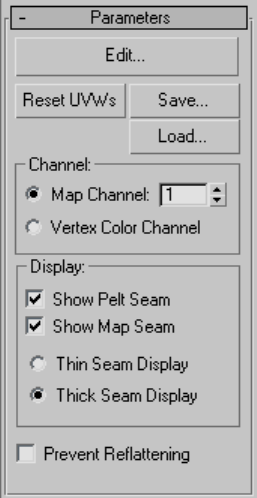
Parameters rollout
Edit Displays the Edit UVWs dialog on page 1788 .
Reset UVWs Resets the UVW coordinates in the Edit UVWs dialog.
Clicking this is almost the same as removing and reapplying the modifier,
except that a map assigned in the Edit UVWs dialog is not deleted. For example,
if you forgot to turn on the Generate Mapping Coordinates check box for an
object, and then applied the Unwrap UVW modifier, the modifier would have
no UVW coordinates to use and its settings would be wrong. If you then go
back in the Stack and turn on Generate Mapping Coordinates, you'd need to
click the Reset UVWs button. When you click this button, an alert warns you
that you're losing any edits you've made.
Save Saves the UVW coordinates to a UVW (.uvw) file.
Load Loads a previously saved UVW file.
1782 | Chapter 9 Modifiers
Channel group
This option lets you choose a specific map channel by number, or the vertex
color channel. For more information, see UVW Map modifier > Channel
group on page 1868 .
When you change channels, the software copies the current edits to the new
channel without alerting you. If you already have edits in that channel from
another modifier (Unwrap UVW or other), those edits could be overwritten.
To ensure preservation of your edits, save them before changing channels and
reload the saved edits as necessary.
Display group
This setting determines whether and how pelt seams and mapping cluster
boundaries, also known as map seams, appear in the viewports:
Show Pelt Seam When on, pelt boundaries appear in the viewports as blue
lines.
Show Map Seam When on, mapping cluster boundaries appear in the
viewports as green lines.
The display thickness setting applies to both pelt seams and map seams:
■Thin Seam Display Displays map seams and pelt seams on object surfaces
in the viewports with relatively thin lines. The line thickness remains
constant as you zoom the view in and out. Uses the Display seams color
on page 1847 .
■Thick Seam Display Displays map seams and pelt seams on object surfaces
in the viewports with relatively thick lines. The line thickness increases
when you zoom the view in and decreases when you zoom out. Uses the
Display seams color on page 1847 . This is the default choice.
Prevent Reflattening This option is used mainly for texture baking. When
turned on, the version of the Unwrap UVW modifier automatically applied
by Render To Texture on page 6169 , named, by default, Automatic Flatten UVs,
will not reflatten the faces. Also, make sure that both Render To Texture and
the modifier are using the same map channel.
Map Parameters rollout
You can apply any map type to selected faces, patches, or surfaces, and align
the mapping gizmo in any of a variety of ways.
Unwrap UVW Modifier | 1783
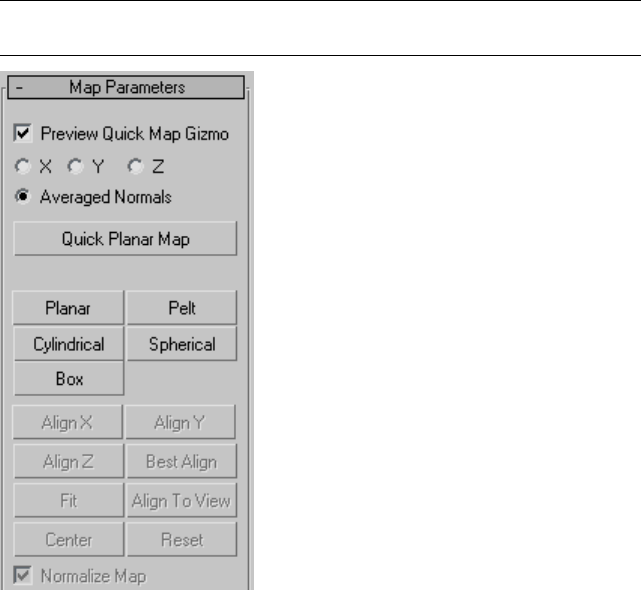
The mapping controls on the upper part of the rollout are available only at
the Face sub-object level.Also, the Quick Map controls are available only when
no mapping mode button (Planar, Pelt, etc.) is active. However, the Pelt
controls on page 1786 are available at all sub-object levels.
NOTE When a mapping type button is active, you cannot change the selection
without first exiting the mapping operation.
Preview Quick Map Gizmo When on, a rectangular planar mapping gizmo,
applicable to the Quick Planar Map tool only, appears juxtaposed over the
face selection in the viewports. This gizmo is not manually adjustable, but
you can use the following control to reorient it.
X/Y/Z/Averaged Normals Choose the alignment for the quick map gizmo:
perpendicular to the object's local X, Y, or Z axis, or based on the faces' average
normals.
Quick Planar Map Applies planar mapping to the face selection based on
the orientation of the Quick Map gizmo.
Planar Applies planar mapping to the selected faces.
1784 | Chapter 9 Modifiers
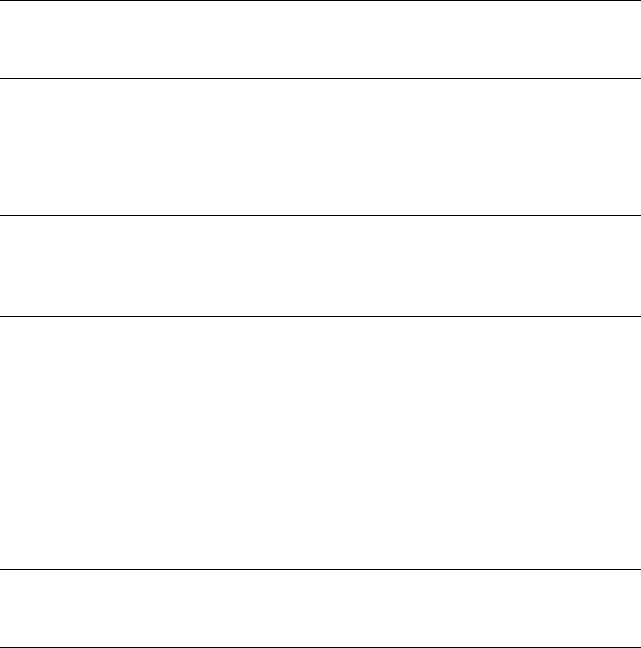
Make the selection, click Planar, adjust the mapping using the transform tools
and Align buttons on the Map Parameters panel, and then click Planar again
to exit.
Pelt Applies pelt mapping to the selected faces. Clicking this button activates
Pelt mode, in which you can adjust the mapping and edit the pelt map on
page 1787 .
NOTE Pelt mapping always uses a single planar mapping for the entire pelt. If
you've applied a different type of mapping, such as Box, and then switch to Pelt,
the previous mapping is lost.
Cylindrical Applies cylindrical mapping to the currently selected faces.
Make the selection, click Cylindrical, adjust the cylinder gizmo using the
transform tools and Align buttons on the Map Parameters panel, and then
click Cylindrical again to exit.
NOTE When you apply Cylindrical mapping to a selection, the software maps
each face to the side of the cylinder gizmo that most closely matches its orientation.
For best results, use Cylindrical mapping with cylinder-shaped objects or object
parts.
Spherical Applies spherical mapping to the currently selected faces.
Make the selection, click Spherical, adjust the sphere gizmo using the transform
tools and Align buttons on the Map Parameters panel, and then click Spherical
again to exit.
Box Applies box mapping to the currently selected faces.
Make the selection, click Box, adjust the box gizmo using the transform tools
and Align buttons on the Map Parameters panel, and then click Box again to
exit.
NOTE When you apply Box mapping to a selection, the software maps each face
to the side of the box gizmo that most closely matches its orientation. For best
results, use Box mapping with box-shaped objects or object parts.
Align X/Y/Z Aligns the gizmo to the X, Y, or Z axis of the object's local
coordinate system.
Best Align Adjusts the mapping gizmo's position, orientation, and scale to
fit that of the face selection, based on the selection's extents and average
normals.
Unwrap UVW Modifier | 1785
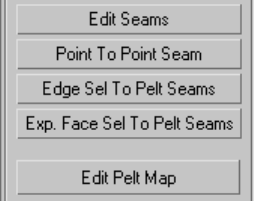
Fit Scales the gizmo to the extents of the selection and centers it on the
selection. Does not change the orientation.
Align To View Reorients the mapping gizmo to face the active viewport and
adjusts its size and position as necessary to fit the extents of the selection.
Center Moves the mapping gizmo so that its pivot coincides with the center
of the selection.
Reset Scales the gizmo to fit the selection and aligns it with the object's local
space.
Normalize Map When on, scales the mapping coordinates to fit into the
standard coordinate mapping space: 0 to 1. When off, the mapping coordinates
are the same size as the object. The map is always tiled once in the 0-1
coordinate space; the part of the map based on its Offset and Tiling values on
For example, if you take a sphere of 25 units that's planar mapped from the
top, and then apply Unwrap UVW and turn off Normalize Map, then when
you open the editor, the radius of the sphere's mapping coordinates is 25
units. As a result, the texture map is tiled onto the sphere surface many times.
With Normalize Map on, both the sphere and the map fit into the 0-1
coordinate space, so they're the same size.
In general, for best results, leave Normalize Map on. One reason to turn it off
would be to turn it off is if you want to map several elements of different
proportions with a texture of a specific aspect ratio, such as brick, keeping the
texture the same size on each object.
[Pelt controls]
These tools, which give you different ways of specifying pelt seams, are
available at all sub-object levels of the modifier.
Edit Seams Lets you specify a pelt seam by selecting edges with the mouse
in the viewports.
1786 | Chapter 9 Modifiers
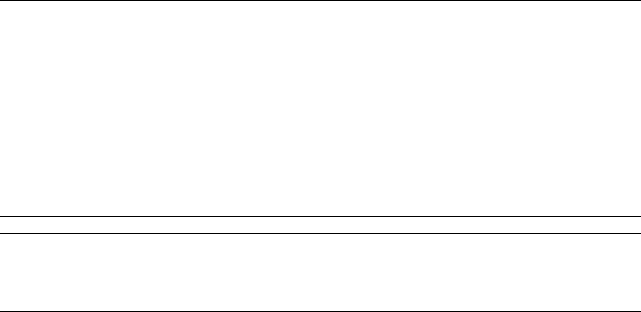
This process is similar but not identical to standard edge selection:
■Click an edge to add it to the current selection.
■Alt+click an edge to remove it from the current selection.
■Drag to select a region.
Point To Point Seam Lets you specify pelt seams by selecting vertices with
the mouse in the viewports. Pelt seams specified with this tool are always
added to the current seam selection.
In this mode, after you click a vertex, a rubber-band line extends from the
vertex you clicked to the mouse cursor. Click a different vertex to create a pelt
seam, and then continue clicking vertices to create a seam from each vertex
to the previous one. To start at a different point in this mode, right-click, and
then click a different vertex. To stop drawing seams, click the button again
to turn it off.
NOTE While Point To Point Seam is active, you can pan, rotate, and zoom the
viewport at any time using contextual controls (middle-button drag,
Alt+middle-button drag, turn mouse wheel, respectively) to access a different part
of the mesh surface. After doing so, the software still remembers the last vertex
you clicked and draws an accurate seam at the next click. Similarly, you can adjust
the viewport using the viewport control buttons on page 7366 and then return to
selecting the seam. If the control requires more than a single click, such as Pan,
exiting the control by right-clicking in the viewport restores the rubber-band line,
extending from the last vertex you clicked.
TIP The algorithm Point To Point Seam uses to calculate a path might create a
different seam than what you have in mind. If this happens, undo (Ctrl+Z) and
specify the desired path by plotting points closer together.
Edge Sel To Pelt Seams Converts the current edge selection to pelt seams.
These seams are added to any existing seams.
Exp(and) Face Sel to Pelt Seams Expands the current face selection to meet
the pelt seam border(s). If multiple seam outlines contain selected faces, the
expansion takes place only for the last-selected face; all others are deselected.
Edit Pelt Map Opens the Edit UVWs dialog in a special Pelt mode, with the
Pelt Map Parameters dialog on page 1826 active. This command also initializes
the mapping coordinates according to the pelt seams. Available only when
Pelt mapping mode on page 1785 is active.
Unwrap UVW Modifier | 1787
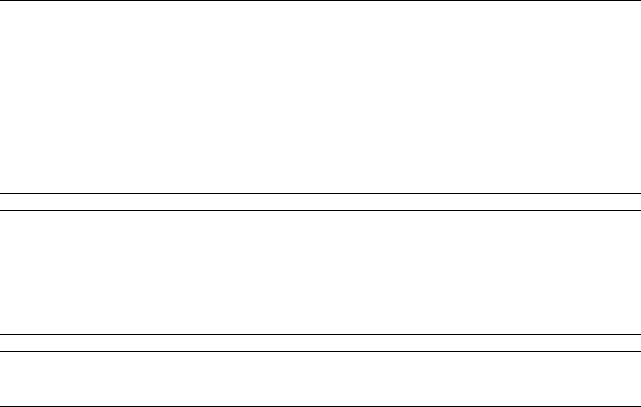
When the editor is open in Pelt mode you can use the editor and dialog
controls to “stretch” out the mapping coordinates, resulting in coordinates
that are easier to texture map.
Edit UVWs Dialog
Select an object. > Modify panel > Modifier List > Object-Space Modifiers >
Unwrap UVW > Edit button (on Parameters rollout)
The heart of the Edit UVWs dialog is a window that displays a lattice made
up of UVW faces and UVW vertices. Each UVW face, which has three or more
vertices, corresponds to a face in the mesh.
The view window displays the UVWs in the 2D-image space of the map,
superimposed over a grid. Thicker grid lines show the boundaries of a texture
map as it would appear in image space; the lower-left corner of the rectangle
has the coordinates (0,0) and the upper-right has the coordinates (1,1). Within
this window, you manipulate the UVW coordinates relative to the map (or
mesh) by selecting the lattice vertices, edges, or faces (collectively known as
sub-objects), and transforming them.
The state of the Edit UVWs dialog, including buttons and selected options, is
stored and recalled the next time you open the Edit dialog.
NOTE You can edit patch object texture coordinates as well as mesh coordinates
in the Edit UVWs dialog. When editing a patch object, you can also edit the vertex
handles. In addition, you can edit the manual interior handles. However, you must
enable the manual interior handles before applying the Unwrap UVW modifier.
To do so, at the Patch sub-object level, select one or more patches, right-click a
selected patch, and then, from the quad menu > tools 1 quadrant, choose Manual
Interior. The manual interior handles appear in the editor window as isolated
vertices.
NOTE Certain modeling operations can leave unused (isolated) map vertices that
show up in the editor window, but cannot be used for mapping. If the model is
an Editable Poly or Edit Poly object, you can use the Remove Unused Map Verts
button on page 2063 at the Vertex sub-object level to automatically delete these
vertices.
TIP The editor can display the number of selected sub-objects. This option is
available as an Unwrap UVW shortcut on page 1807 as Show Subobject Counter.
1788 | Chapter 9 Modifiers
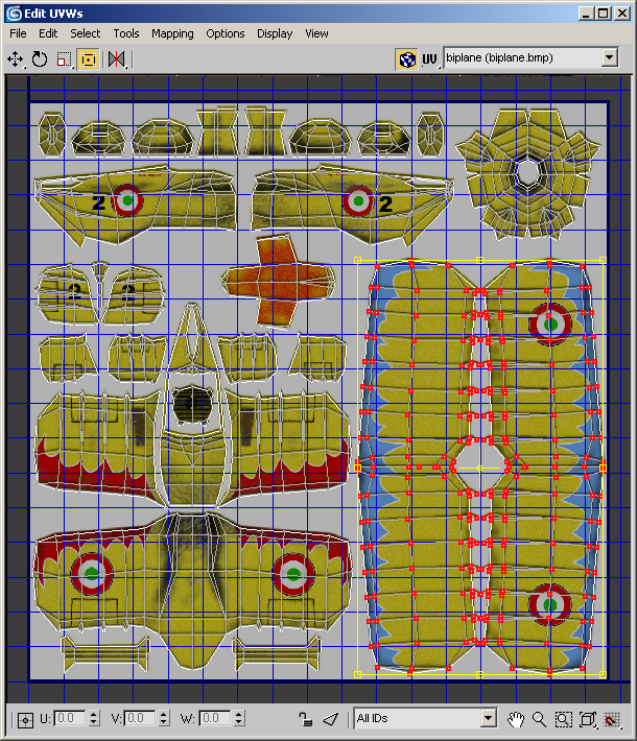
Interface
Besides the window, the editor interface consists of a menu bar, a toolbar, a
lower toolbar, and, docked below the main dialog, the Options panel on page
1795 .
Menu bar
The menu bar provides access to a wide range of Edit UVWs functions. See
Edit UVWs Dialog Menu Bar on page 1799 .
Unwrap UVW Modifier | 1789

Toolbar
Contains all the controls for manipulating the texture sub-objects in the view
window, navigating within the window, and setting other options. When
transforming with Rotate and Scale, pressing Ctrl+Alt will allow you to
transform the selection from the point of the mouse click, instead of the
selection center. The initial click specifies the center of the transform.
Move Lets you select and move sub-objects. Flyout options are Move,
Move Horizontal, and Move Vertical. Press Shift to constrain the movement
to a single axis.
Rotate Lets you select and rotate sub-objects.
Scale Lets you select and scale sub-objects. Flyout options are Scale,
Scale Horizontal, and Scale Vertical.
Pressing Shift as you scale constrains the transform to a single axis.
Freeform Mode Lets you select and move, rotate, or scale vertices,
depending on where you drag. After you make a selection, the Freeform gizmo
appears as a rectangular bounding box around the selected vertices. As you
move the cursor over the gizmo's various elements and inside the gizmo, the
cursor's appearance, and the result of starting to drag in this location, change:
■Move Position the cursor anywhere inside the gizmo and then
drag to move the selection. To constrain movement to the vertical or
horizontal axis, depending on how you begin dragging, press and hold
Shift before dragging.
■Rotate Position the cursor over a gizmo edge center point, and
then drag to rotate the selection about the pivot. As you drag, the amount
of rotation is shown in the center of the gizmo.
Ctrl+drag to rotate in five-degree increments; Alt+drag to rotate in
one-degree increments. Freeform rotation respects the angle snap on page
2570 status.
1790 | Chapter 9 Modifiers
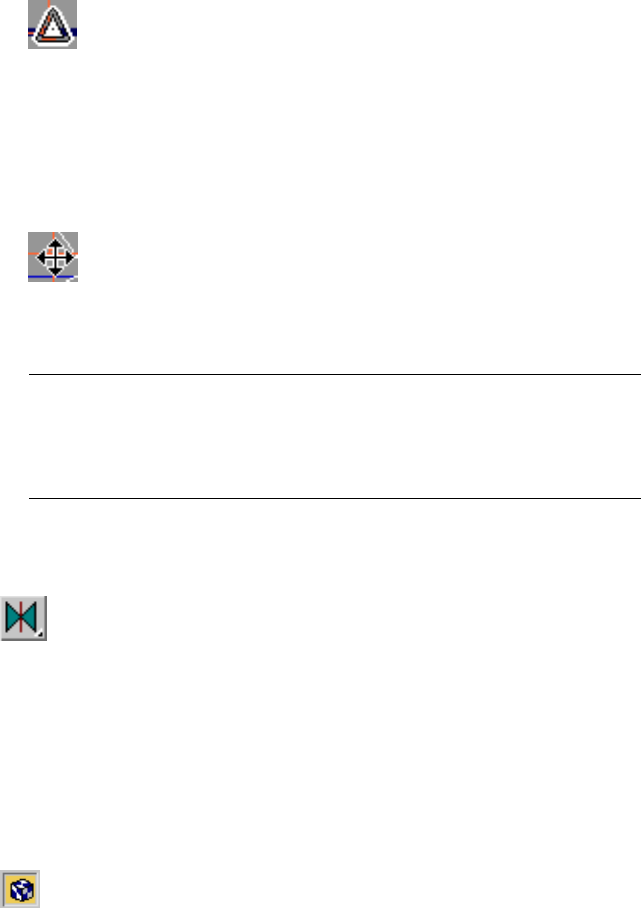
■Scale Position the cursor over a gizmo corner and then drag to
scale the selection. By default, scaling is non-uniform; if you press and
hold Ctrl before dragging, scaling is uniform on the horizontal and vertical
axes. Press and hold Shift before dragging to constrain scaling to the vertical
or horizontal axis, depending on how you begin dragging.
By default, scaling takes place about the gizmo center. If you've moved the
pivot (see following item), you can scale about the transform center instead
by pressing and holding Alt before dragging.
■Move pivot Position the cursor over the pivot, a wireframe cross
that appears by default at the center of the gizmo. When this cursor appears,
drag to move the pivot. Rotation always occurs about the pivot; scaling
takes place about the pivot if you press and hold Alt before dragging.
TIP By default, the pivot always resets to the center of the gizmo when you
make a new selection. If you prefer to retain the offset from selection to
selection, you can toggle this feature with the Reset Pivot On Selection
command. This command is not available in the editor interface by default;
you must use the Customize User Interface dialog on page 7489 to add it.
If you Ctrl+select one or more vertices outside the gizmo, the gizmo expands
to encompass the entire selection.
Mirror Mirrors selected vertices and flips UVs. Flyout options are Mirror
Vertical, Mirror Horizontal, Flip Horizontal, and Flip Vertical.
Flip first detaches the selection along its boundary edges and then applies a
Mirror Horizontal or Vertical depending on the mode.
Turn on Target Weld, and then drag one vertex to another vertex, or one edge
to another edge. As you drag, the cursor changes in appearance to cross hairs
when it's over a valid sub-object. While this command is active, you can
continue welding sub-objects, and change the sub-object level. To exit Target
Weld mode, right-click in the editor window.
Show Map Toggles the display of the map in the editor window.
Unwrap UVW Modifier | 1791
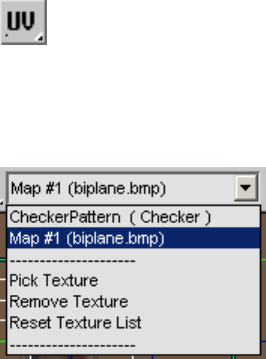
UV/VW/UW By default, the UV portion of the UVW coordinates is
displayed in the view window. However, you can switch the display to edit
the UWs or the VWs.
[texture list drop-down] Contains all the maps of the material assigned to
the object.
The names of the maps assigned in the Material Editor and in the Edit UVWs
dialog (via Pick Texture) appear in the list.
Below the map names are several commands:
■Pick Texture Lets you use the Material/Map Browser to add and display
textures that are not in the object's material.
■Remove Texture Eliminates the currently displayed texture from the
editor.
■Reset Texture List Returns the texture list to the current state of the
applied material, removing any added textures and restoring any removed
textures that were part of the original material, if they still exist in the
material. This command also adds any new maps in the material, so it
essentially updates the UVW editor to the current state of the material.
Choose a map you want to use in the view window. For example, you might
use a bump or texture map as a reference to move UVW vertices.
A checker texture named CheckerPattern (Checker), useful for checking for
distorted areas of the texture mapping, is built in to the Edit UVWs dialog. By
default, this texture appears as the background texture when you first open
the editor after applying Unwrap UVW to an object. To cause the pattern to
appear on the object in viewports set to display textures, choose it from the
drop-down list, even if it's already active in the editor.
1792 | Chapter 9 Modifiers
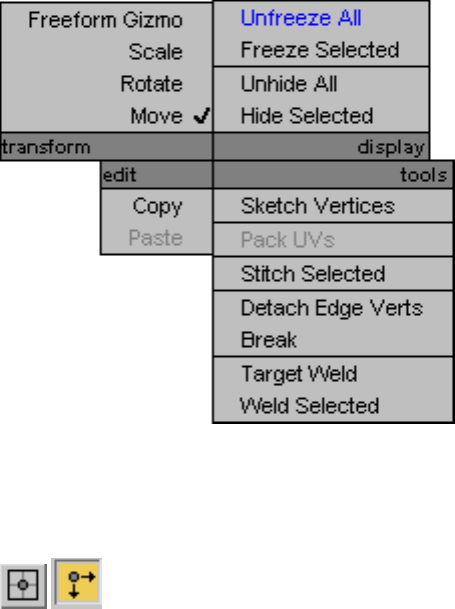
Edit UVWs window
The Edit UVWs window allows you to edit UVW sub-objects to adjust the
mapping on a model. For example, a texture map might contain the side, top,
and front views of a car. By first planar mapping the top, side, and front faces
of the model at the Face sub-object level, you can adjust the texture coordinates
for each selection to fit the different parts of texture map to the corresponding
areas on the car.
To edit the UVW vertices, first choose a transform tool and sub-object mode,
make a selection, and then click and drag in the window to transform the
selection.
Quad menu Right-click in the window to display the quad menu, which
provides access to all the transform tools, as well as a number of editor
commands.
Commands to freeze and hide selected sub-objects and unfreeze/unhide all
sub-objects are found only in the quad menu.
Lower Toolbar
Absolute/Offset Mode When this is off, the software treats
values you enter into the U, V, and W fields (see following) as absolutes. When
Unwrap UVW Modifier | 1793
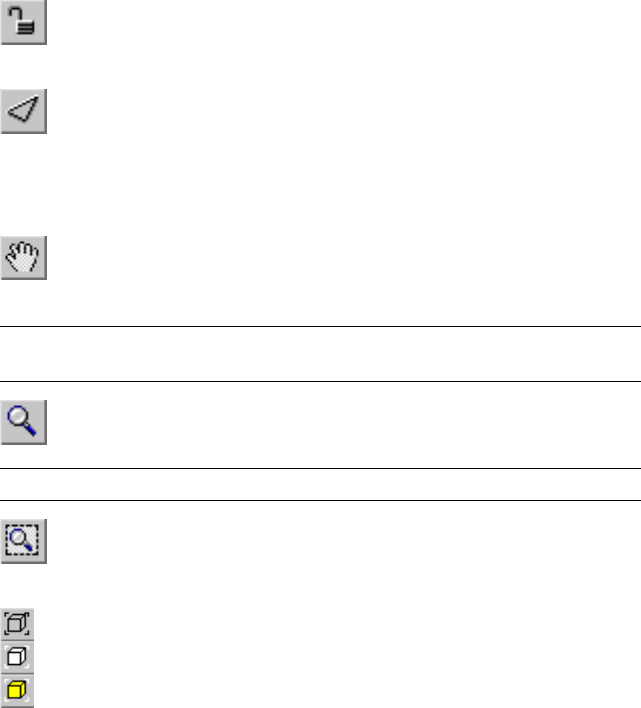
this is on, the software applies transform values you enter as relative to current
values; that is, as offsets. Default=off.
U, V, and W These fields display the UVW coordinates for the current
selection. Use the keyboard or the spinners to edit them.
These fields are active at all sub-object levels, but they always apply to vertices.
With a single vertex selected, they display the current coordinates. With
multiple vertices (or one or more edges or faces) selected, they display any
coordinates the vertices belonging to the selection have in common; otherwise,
they're blank.
Lock Selection Locks selection. You can move selected sub-objects
without touching them.
Filter Selected Faces Displays UVW vertices of the object's selected
faces in the viewport, and hides the rest.
All ID's (drop-down) Filters the object's material IDs. Displays texture faces
that match the ID drop-down.
Pan Click Pan, and then drag in the window to change the visible
portion.
TIP With a three-button mouse, you can also pan the window by dragging with
the middle mouse button held down.
Zoom Click Zoom, and then click+drag to zoom the window.
TIP With a wheel mouse, you can also zoom by turning the wheel.
Zoom Region Click Zoom Region, and then region-select part of the
window to zoom in.
Zoom Extents Zooms in or out to fit the texture coordinates in the
window. The flyout buttons, from top to bottom, let you zoom to all texture
1794 | Chapter 9 Modifiers
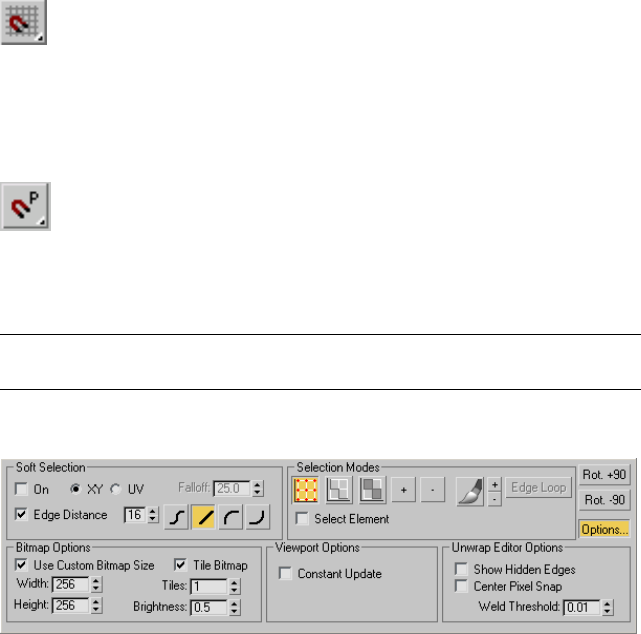
coordinates, to the current selection, and to all clusters/elements containing
any selected sub-objects.
Grid Snap When on, moving sub-objects tends to snap the vertex
closest to the mouse cursor, which is highlighted by a square outline, to the
nearest grid line or intersection.
This is the default tool on this flyout; Pixel Snap is also available.
You can set the snap strength in the Unwrap Options dialog on page 1849 .
Pixel Snap Snaps to the nearest pixel corner when you have a bitmap
in the background. Available from the Grid Snap flyout.
Combine this with Center Pixel Snap on page 1799 to snap to the center of
pixels rather than the corner.
NOTE With multiple vertices selected, all vertices snap to the nearest pixel,
relatively; this can slightly alter the spatial relationships among them.
Options panel
By default, the Options panel, docked to the bottom of the Edit UVWs dialog,
provides controls for using soft selection, specifying selection modes, and
rotating the selection. The Options button lets you toggle the display of
additional settings for bitmaps, viewports, and the editor.
Soft Selection group
The Soft Selection controls make a sub-object selection behave as if surrounded
by a "magnetic field." Unselected sub-objects within the field are drawn along
smoothly while you transform the sub-object selection, the effect diminishing
with distance. You can adjust this distance, or “falloff,” whether it applies to
Unwrap UVW Modifier | 1795

object space, texture space, or edge space, and the formula by which it
diminishes.
First, set a value that encompasses sub-objects to be moved or scaled, and then
transform sub-objects with a falloff effect.
On Activates or deactivates soft selection.
XY/UV Specifies object or texture space for the falloff distance. XY selects
object space, UV selects texture space.
Falloff Sets the falloff distance. As values increase, unselected vertex colors
change gradually from the selected vertex to reflect the area of influence.
Edge Distance Turn on to limit the falloff region by the specified number
of edges between the selection and the affected vertices. The affected region
is measured in terms of "edge-distance" space rather than absolute distance.
Falloff Type Transforming with soft selection affects non-selected vertices
within the falloff area based on the falloff type.
The icons depict how their buttons affect falloff. The options are:
■ Smooth
■ Linear
■ Slow Out
■ Fast Out
Selection Modes group
[sub-object mode] Specifies the type of sub-object that you can select by
clicking or dragging in the window. Default=Vertex.
One of the three sub-object modes can be active at a time:
■ Vertex
1796 | Chapter 9 Modifiers
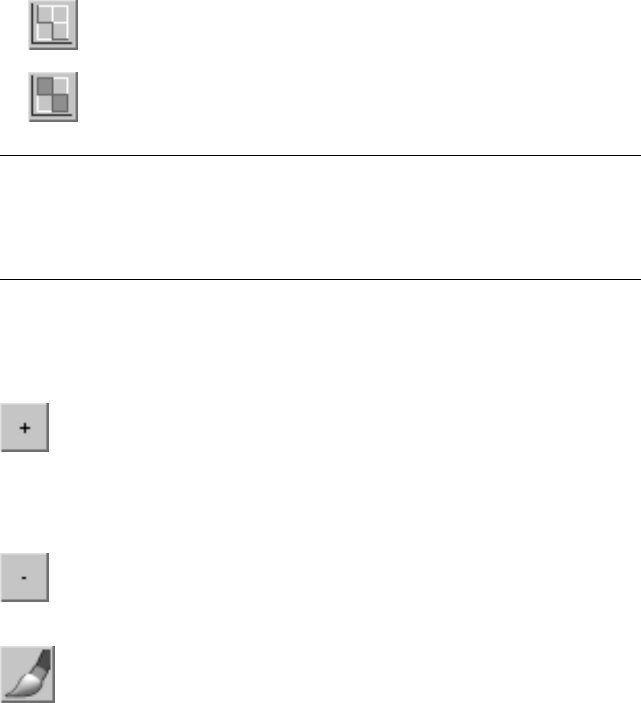
■ Edge
■ Face
NOTE Selected sub-objects are colored red by default. Also, in Edge and Face
sub-object modes, any shared edges are blue by default. A shared edge is one
both of whose endpoints are shared by a selected edge or face; thus, it is, in effect,
also selected. You can change these colors using Customize User Interface > Colors
panel on page 7505 .
The three sub-object levels are synchronized between the modifier stack on
page 1779 of the Unwrap UVW modifier and the Selection Modes group. When
you choose a sub-object level in one, it's also activated in the other. Similarly,
selecting sub-objects in a viewport selects them in the editor and vice-versa.
Expand Selection Adds sub-objects to the selection.
Vertex and face expansion proceeds outwards in all available directions. Edge
expansion proceeds along available UV paths. For example, to select a cluster
outline, select one outer edge, and then click Expand Selection repeatedly.
Contract Selection Shrinks the selection by deselecting the outermost
sub-objects.
Paint Select Mode Lets you “paint” a sub-object selection by dragging
in the editor window. After activating this mode, move the cursor into the
editor window, and then drag to select sub-objects. To exit Paint Select mode,
right-click or choose a transform tool.
Paint mode selects only sub-objects that are fully inside the selection brush.
The dotted circle attached to the mouse shows the size of the brush. Use the
+/- buttons next to the paintbrush button to change its size.
+/- Increases and decreases the size of the Paint Select mode “brush”: the
circle attached to the mouse cursor.
Edge Loop Expands an existing edge selection to select all edges in the loop
attached to the selected edges. Select one or more edges, and then click Edge
Loop.
Unwrap UVW Modifier | 1797

Edge Loop uses a “center-path” method to calculate loop selection. To be able
to expand a selection, there must be an odd number of edges attached to
either end of a selected edge in the editor window. The software then selects
the middle connected edge, and then continues selecting as long as it can
using each newly selected edge. When it encounters an edge connected to an
even number of edges, or to which the middle edge is already selected, it stops.
Select Element Selecting a sub-object in a cluster causes the entire cluster to
become selected. Works in all sub-object modes.
Rot(ate) +90 Rotates the selection 90 degrees about its center.
Rot(ate) -90 Rotates the selection -90 degrees about its center.
Bitmap Options group
Click the Options Button to make this group available.
Use Custom Bitmap Size When turned on, scales the bitmap texture to the
values specified by Width and Height. You can adjust these settings to scale
and reproportion the bitmap texture in relation to the texture coordinates.
This scaling doesn't affect the bitmap in the material, but only as viewed in
the editor.
TIP When working with large textures, reduce the bitmap size for faster feedback.
And when working with disproportionate textures, setting the dimensions closer
to each other in the editor can make it easier to work.
Width Scales the bitmap along the horizontal axis.
Height Scales the bitmap along the vertical axis.
Tile Bitmap When turned on, you can repeat the bitmap in the editor,
displaying tiling set in the material. You can use any part of the tiled image
for setting texture coordinates. This is helpful when the sections of the texture
image are packed tightly together and the mesh contains many different areas
to map.
Tiles The number of times the texture image is repeated, counting outward
in eight directions (the four corners and the four sides).
With Tiles=1, the result is a 3 x 3 grid. With Tiles=2, the result is a 5 x 5 grid,
and so on.
Brightness Sets the brightness of the tiled bitmap. At 1.0, the brightness
equals that of the original image; at 0.5 it's half the brightness; and at 0, it's
black.
1798 | Chapter 9 Modifiers
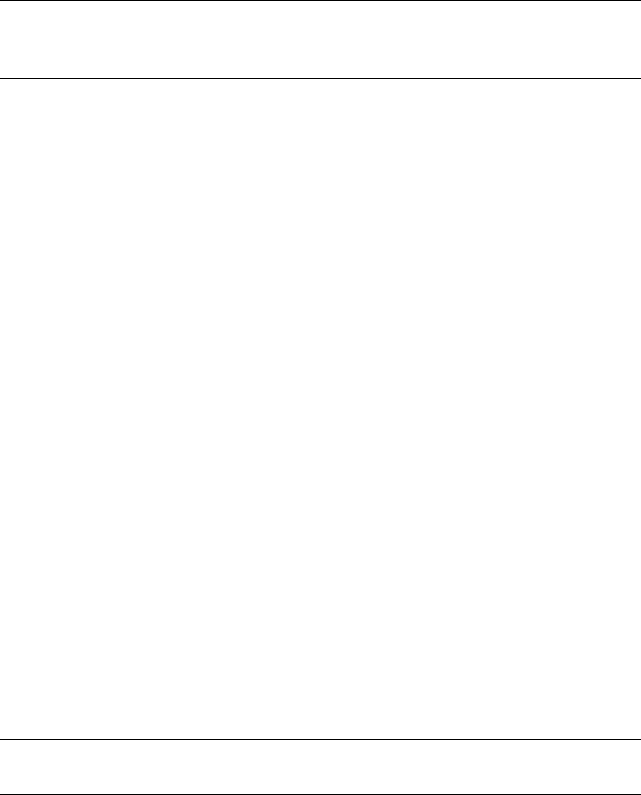
TIP Turning off Affect Center Tile, available in the Unwrap Options dialog on
page 1845 > Display Preferences group, prevents the Brightness setting from affecting
the center tile, so it's easier to find if you've turned down the brightness.
Viewport Options group
Constant Update When on, the viewports update in real-time, reflecting
any changes to the texture coordinates as you make them. When off, the
viewports update only after you finish transforming texture coordinates (that
is, when you release the mouse button).
Unwrap Editor Options group
Show Hidden Edges Toggles the display of face edges. When turned off, only
faces appear. When turned on, all mesh geometry appears.
Center Pixel Snap When Pixel Snap on page 1795 is turned on, snaps to the
center of pixels of the background images instead of pixel edges.
Weld Threshold Sets the radius within which welding using Weld Selected
takes effect. The setting is in UV-space distance. Default=0.01. Range=0 to 10.
Edit UVWs Dialog Menu Bar
Select an object. > Modify panel > Modifier List > Object-Space Modifiers >
Unwrap UVW > Edit button (on Parameters rollout) > Menu bar
The Edit UVWs dialog on page 1788 menu bar provides access to a number of
important editing commands. Some of these commands are replicated on the
dialog toolbar and the Unwrap UVW command panel; others, such as the
Mapping, Stitch, and Sketch tools, are available only from the menus.
TIP Several commands are not available in the editor interface by default; you can
use the Customize User Interface dialog on page 7489 to add them.
Interface
File menu
Load UVs Loads a previously saved UVW (texture coordinates) file.
Save UVs Saves the UVW coordinates to a UVW file.
Reset All Restores the UVW coordinates to their original status.
Unwrap UVW Modifier | 1799

Reset All has almost the same effect as removing and reapplying the modifier,
except that a map assigned in the Edit UVWs dialog is not deleted. For example,
if you forgot to turn on the Generate Mapping Coordinates check box for an
object, and then applied the Unwrap UVW modifier, the modifier would have
no UVW coordinates to use and its settings would be wrong. If you then go
back in the modifier stack and turn on Generate Mapping Coordinates, you'd
need to choose the Reset All command. When you do so, an alert warns you
that you're losing any edits you've made.
Edit menu
These commands provide access to the different transform functions, and
copy and paste selections.
Copy Copies the current selection (i.e., texture coordinates) into the paste
buffer.
Paste Applies the texture mapping coordinates in the paste buffer to the
current selection. Using Paste repeatedly with the same target coordinates
causes the coordinates to rotate by 90 degrees each time.
Use Copy and Paste to apply the same mapping coordinates (i.e., image) to a
number of different geometry faces. A typical example of usage would be in
designing a game level, where you're working with a multi-image texture map,
part of which is a door image. You might want to apply the same door image
to several different door polygons. First, you would select one of the door
polys and position it over the door image. Next, use Copy to place its texture
coordinates in the paste buffer. Then select another door poly and choose
Paste or Paste Weld. The door's texture coordinates move to the same location
as the original poly. Continue selecting other door polys and pasting until all
the doors are mapped.
TIP For best results, use comparable sets of texture coordinates for the source and
destination. For example, copy a single four-sided face, and then paste another
four-sided face.
Paste Weld Applies the contents of the paste buffer to the current selection
and then welds coincident vertices, effectively fusing the source and
destination selections together.
Use this function to end up with a single set of texture coordinates that's
applied to multiple geometry elements. Adjusting these texture coordinates
changes the mapping for all geometry to which they're applied.
Move Mode Lets you select and move sub-objects.
1800 | Chapter 9 Modifiers
Rotate Mode Lets you select and rotate sub-objects.
Scale Mode Lets you select and scale sub-objects.
Freeform Gizmo Lets you select and transform vertices. See Freeform Mode
on page 1790 .
Select menu
These commands let you copy a viewport selection to the editor, and transfer
selections among the three different sub-object modes.
Convert Vertex to Edge Converts the current vertex selection to an edge
selection and places you in Edge sub-object mode. For an edge to be selected,
both of its vertices must be selected.
Convert Vertex to Face Converts the current vertex selection to a face
selection and places you in Face sub-object mode. For a face to be selected, all
of its vertices must be selected.
Convert Edge to Vertex Converts the current edge selection to a vertex
selection and places you in Vertex sub-object mode.
Convert Edge to Face Converts the current edge selection to a face selection
and places you in Face sub-object mode. For a face to be selected, the current
edge selection must include all of its vertices. For example, if two opposite
edges of a four-sided face are selected, the edge selection includes all four of
the face's vertices, so this command will select the face.
Convert Face to Vertex Converts the current face selection to a vertex
selection and places you in Vertex sub-object mode.
Convert Face to Edge Converts the current face selection to an edge selection
and places you in Edge sub-object mode.
Select Inverted Faces Selects any faces facing away from the current mapping.
Available only in Face selection mode on page 1797 .
This is useful in complex models for finding faces on a surface that folds in
under itself, thus causing potential problems with bump mapping.
For example, add a sphere, turn off Generate Mapping Coords, and them apply
Unwrap UVW. This causes the modifier to apply planar mapping from the
top down, so that all faces on the bottom half of the sphere are “inverted”;
that is, they face away from the mapping. In the modifier stack display,
highlight the Select Face sub-object level, and then click the Edit button to
open the UVW editor. Choose the Face selection mode, and then choose Select
> Select Inverted Faces. In the viewports, the bottom half of the sphere turns
red to indicate that the inverted faces are now selected.
Unwrap UVW Modifier | 1801
Select Overlapped Faces Selects any faces that overlap other faces. If no face
is selected, this selects all overlapping faces. If a face selection exists, this selects
only overlapping faces within the selection. Available only in Face selection
mode on page 1797 .
When working with complex meshes, it's common for texture-coordinate
faces to overlap one another, with the result that they use the same portion
of the texture map. Use this command to find overlapping faces in order to
separate them as needed.
Tools menu
Tools on this menu let you flip and mirror texture coordinates, weld vertices,
combine and separate sets of texture coordinates, and sketch outlines for
multiple selected vertices.
Flip Horizontal/Vertical Detaches the selected sub-objects along their
boundary edges and then applies Mirror Horizontal or Vertical, depending on
the mode.
Mirror Horizontal/Vertical Reverses the direction of selected sub-objects
along the indicated axis and flips UVs accordingly.
Weld Selected Welds selected sub-objects to a single vertex, based on the
Weld Threshold setting. You can set the threshold on the Options panel >
Unwrap Editor Options group, as well as on the Unwrap Options dialog on
page 1845 > Misc. Preferences group.
Target Weld Welds pairs of vertices or edges. Not available at the Face
sub-object level.
Turn on Target Weld, and then drag one vertex to another vertex, or one edge
to another edge. As you drag, the cursor changes in appearance to cross hairs
when it's over a valid sub-object. While this command is active, you can
continue welding sub-objects, and change the sub-object level. To exit Target
Weld mode, right-click in the editor window.
Break Applies to the current selection; works differently in the three
sub-object modes. At the Vertex sub-object level, Break replaces each shared
vertex with two vertices. With edges, Break requires at least two contiguous
edges to be selected, and separates each edge into two. With faces, Break splits
the selection off from the rest of the mesh into a new element, exactly as does
Detach Edge Verts.
Detach Edge Verts Tries to split off the current selection into a new element.
Any invalid vertices or edges are removed from the selection set before the
detach.
1802 | Chapter 9 Modifiers

Stitch Selected For the current selection, finds all the texture vertices that
are assigned to the same geometric vertex, brings them all to the same spot,
and welds them together. With this tool you can automatically connect faces
that are contiguous in the object mesh but not in the editor.
To use Stitch Selected, first select sub-objects along an edge you want to
connect (by default, this causes the shared edges to highlight), and then choose
the command. In the Stitch Tool dialog on page 1841 , adjust the settings, and
then click OK to accept or Cancel to abort.
Pack UVs Distributes all texture-coordinate clusters through the texture space
using one of two methods and spacing you specify. This is useful if you have
several overlapping clusters and wish to separate them.
Choosing Pack UVs opens the Pack dialog on page 1825 .
Sketch Vertices Lets you draw outlines for vertex selections with the mouse.
This is useful for matching coordinate cluster outlines to sections of the texture
map en masse, without having to move vertices one at a time.
Choosing Sketch Vertices opens the Sketch Tool dialog on page 1839 . Sketch
Vertices is available only in the Vertex sub-object mode.
Relax Dialog Opens the non-modal Relax Tool dialog on page 1831 , which
lets you change the apparent surface tension in a selection of texture vertices
by moving vertices closer to, or away from, their neighbors. Relaxing texture
vertices can make them more evenly spaced, resulting in easier texture
mapping. Available at all sub-object levels.
NOTE This command, as well as a Relax command that lets you apply the default
settings to the current selection without opening the dialog, are available as
assignable keyboard shortcuts on page 1807 .
Render UVW Template Opens the Render UVs dialog on page 1835 , which
lets you export texture mapping data as an image file that you can then import
into 2D paint software.
Mapping menu
Lets you apply one of three different types of automatic, procedural mapping
methods to a model. Each method provides settings so you can adjust the
mapping to the geometry you're using.
With each method, the mapping is applied to the current face selection; if
there is no face selection it is applied to the entire mesh.
Unwrap UVW Modifier | 1803

Here's a quick overview of the three methods:
■Flatten mapping prevents overlap of mapping clusters, but can still cause
texture distortion.
■Normal mapping is the most straightforward method, but can result in
even greater texture distortion than with Flatten mapping.
■Unfold mapping eliminates texture distortion, but can result in overlapping
coordinate clusters.
TIP In many cases, one of the automatic mapping functions will provide useful
results. But with certain custom or complex objects, you might get the best results
with manual mapping; use a variation of the basic procedure on page ? , or use
a procedural method as a starting point for custom mapping.
Flatten Mapping Applies planar maps to groups of contiguous faces that fall
within a specified angle threshold.
Choosing Flatten Mapping opens the Flatten Mapping dialog on page 1821 .
Normal Mapping Applies planar maps based on different vector-projection
methods.
Choosing Normal Mapping opens the Normal Mapping dialog on page 1823 .
Unfold Mapping Unfolds the mesh so you get no face distortion, but does
not guarantee that faces will not overlap.
Choosing Unfold Mapping opens the Unfold Mapping dialog on page 1843 .
Options menu
Load Defaults Loads the editor settings from the file unwrapuvw.ini in the
plugcfg directory.
Save Current Settings as Default Saves the editor settings to the file
unwrapuvw.ini in the plugcfg directory. Settings saved in this way persist between
sessions.
Always Bring Up The Edit Window When on, selecting an object with the
Unwrap UVW modifier active automatically opens the Edit UVWs dialog. By
default, this is off, so you must click the Parameters rollout > Edit button to
open the dialog.
Preferences Opens the Unwrap Options dialog on page 1845 .
1804 | Chapter 9 Modifiers
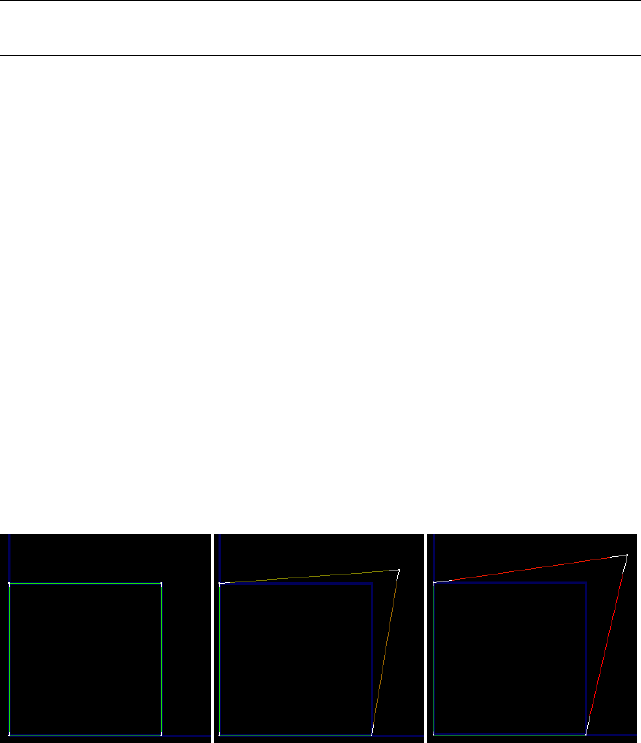
Display menu
Hide Selected Hides all selected sub-objects and associated faces.
Unhide All Reveals any hidden sub-objects.
Unfreeze All Unfreezes any frozen sub-objects.
NOTE You can freeze a sub-object selection with Freeze Selected, available from
the right-click menu > Display quadrant.
Filter Selected Faces When on, the editor displays UVW vertices of the
viewport selection at the Face sub-object level of the modifier, and hides the
rest.
This is a quick way to work on a limited selection of the texture coordinates
of a complex mesh while ignoring the rest. You can turn this on, go to the
Face sub-object level of the Unwrap UVW modifier, and select the portion of
the object whose texture coordinates you want to edit; only those coordinates
appear in the editor, and remain visible even when you change the sub-object
level. To work on a different portion, return to the Face level and change the
selection in the viewport; the editor window updates to the new selection
automatically.
Show Hidden Edges Toggles the display of hidden face edges.
Show Edge Distortion Uses a green-to-red color range to depict distortion:
how far in length texture edges are from their corresponding geometry edges.
The greater the disparity in lengths (that is, the greater the distortion), the
redder the edge appears in the Edit UVW dialog window. Also draws end
segments of edges that are too long as white, showing the difference in length
from that of the geometry edge.
Left: Texture edges the same as or very close to geometry edges in length are green.
Center: Texture edges slightly different from geometry edges in length are brown.
Right: Texture edges very different from geometry edges in length are red.
Unwrap UVW Modifier | 1805
When texture edges are longer than geometry edges, white end segments depict
length disparity.
Use this display as a way to view where the areas of greatest distortion are in
your texture mesh. If an edge is brown or red but doesn't have white end
segments, it's too short. If it's brown or red and has white end segments, it's
too long, by the total length of the white segments.
Show Vertex Connections In Vertex sub-object mode, toggles the display of
numeric labels for all selected vertices. Shared vertices are indicated by the
appearance of multiple same-numbered labels.
Show Shared Sub-objects When turned on, for the current selection,
highlights any shared vertices and/or edges. You can change the highlight
color on the Unwrap Options dialog on page 1845 .
View menu
Pan Activates the Pan tool, which lets you move horizontally and vertically
in the window by dragging the mouse.
As with the viewports, if you use a three-button mouse, you can also pan by
middle-button dragging.
Zoom Choose Zoom, and then drag downward in the editor window to
zoom out and upward to zoom in. Zooming is centered about the point you
click before dragging.
If you have a wheel mouse, you can also turn the wheel to zoom. Zooming is
centered about the mouse cursor location.
Zoom Region To zoom to a specific area, choose Zoom Region, and then
drag a rectangle in the editor window.
Zoom Extents Zooms in or out to fit all UVW vertices in the editor window.
Zoom Extents Selected Zooms in or out to fit all selected UVW vertices in
the editor window.
Zoom To Gizmo Zooms the active viewport to the current selection.
Zoom Extents Selected Zooms in or out to fit all selected UVW vertices in
the window.
Show Grid Displays a grid in the background of the editor window.
Default=on.
Show Map Displays a texture map in the background of the editor window.
Set the image via the drop-down list at the right end of the editor toolbar.
1806 | Chapter 9 Modifiers
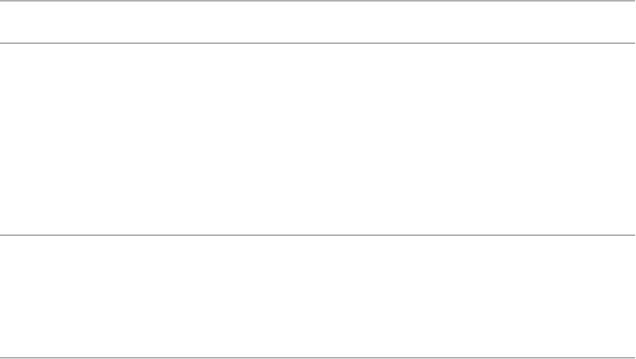
Update Map Causes the displayed texture map to reflect any changes to the
texture, such as tiling settings or a different bitmap.
Unwrap UVW Shortcuts
To use keyboard shortcuts for the Unwrap UVW modifier, the Keyboard
Shortcut Override Toggle on page 7646 must be on.
See also:
■Unwrap UVW Modifier on page 1769
■Keyboard Shortcuts on page 7645
■Keyboard Panel on page 7489
■Customize User Interface Dialog on page 7489
In general, this table includes only functions that have default keyboard
shortcuts and functions with descriptions that are not documented in the
Unwrap UVW reference topics.
DescriptionKeyboard ShortcutUnwrap UVW Function
Lets you select vertices in-
side the gizmo by
Allow Selections Inside
Transform Gizmo
CTRL+clicking or
ALT+clicking a vertex.
When turned on, you can
move only by dragging
over empty space.
When on, the Edit UVWs
dialog automatically opens
Always Bring Up The Edit
Window
when you access the Un-
wrap UVW modifier.
Lets you blend the image
in the Edit UVWs dialog
Blend Tiles To Background
with the background color.
At 0 the image will be hid-
Unwrap UVW Modifier | 1807
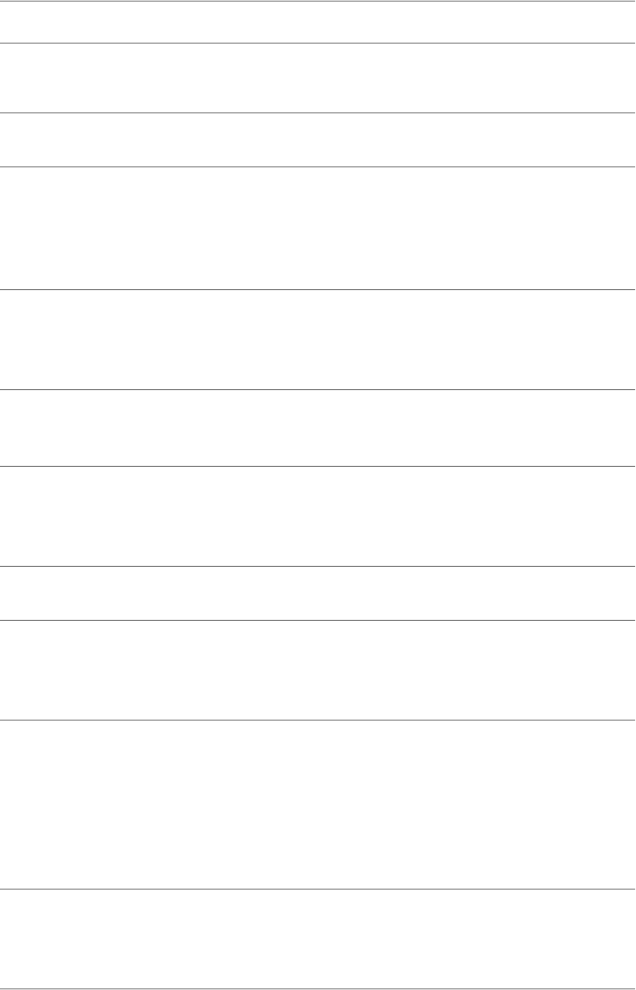
DescriptionKeyboard ShortcutUnwrap UVW Function
den while at 1 it will be at
full intensity.
Box Map
Breaks selected vertices so
no face shares them; the
Ctrl+BBreak Selected Vertices
same as breaking a vertex
in Edit Mesh.
The brightness control for
the tile of image at 0,0 of
the Edit UVWs dialog.
Brightness Affects Center
Tile
Shrinks the face selection
in the viewport.
Contract Geom. Faces
Copies the current face se-
lection texture data into
the paste buffer.
Copy
Cylindrical Map
Detaches the selected ver-
tices into a separate ele-
ment.
D, CTRL+DDetach Edge Vertices
Highlights edges that are
seams in texture space in
Display Seams
the Edit UVWs dialog. A
seam is an edge that has
only one face attached to
it.
Converts the edge selection
to pelt seams, adding to
the current pelt seams.
Edge Sel to Pelt Seam
(Add)
1808 | Chapter 9 Modifiers
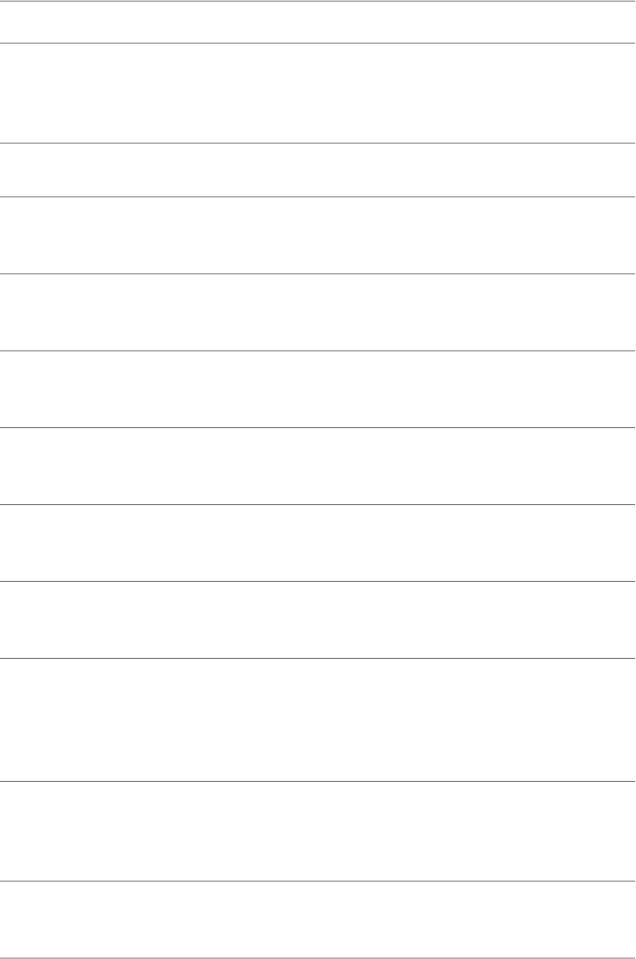
DescriptionKeyboard ShortcutUnwrap UVW Function
Converts the edge selection
to pelt seams, replacing the
current pelt seams.
Edge Sel to Pelt Seam (Re-
place)
Edge Snap
Converts an edge selection
into a face selection.
Edge to Face Select
Converts an edge selection
into a vertex selection.
Edge to Vertex Select
Opens the Edit UVWs dia-
log.
Ctrl+EEdit UVWs
Grows the face selection in
the viewport.
Expand Geom. Faces
Converts a face selection
into an edge selection.
Face to Edge Select
Converts a face selection
into a vertex selection.
Face to Vertex Select
When on, only faces that
are selected in the viewport
Alt+FFilter Selected Faces
will be displayed in the Edit
UVWs dialog.
Lays out the UV space so
that no texture faces over-
lap.
Flatten Map
Opens the dialog for Flat-
ten Mapping settings.
Flatten Map Dialog
Unwrap UVW Modifier | 1809
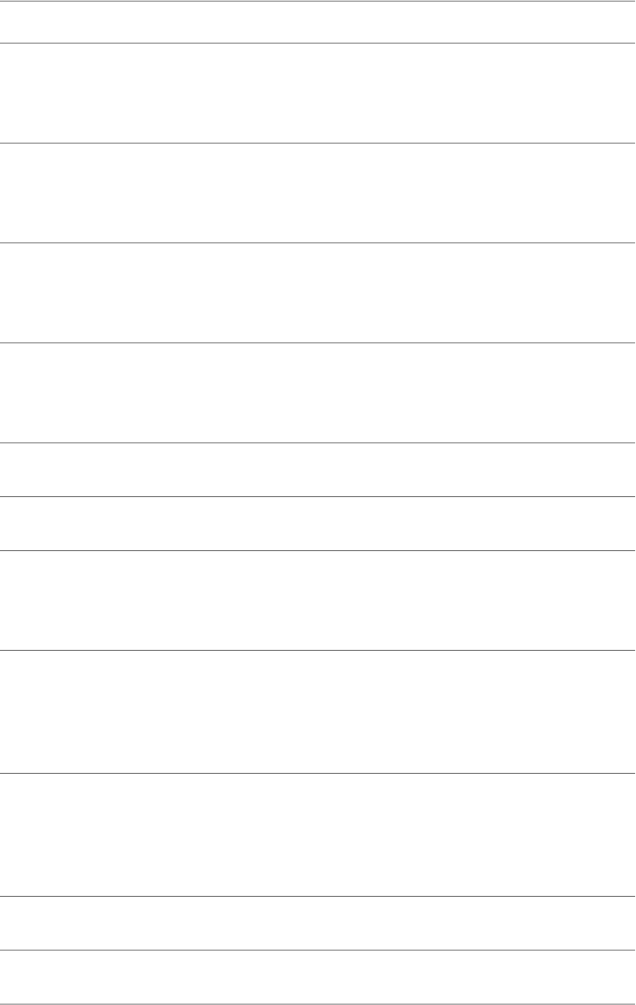
DescriptionKeyboard ShortcutUnwrap UVW Function
Detaches the current selec-
tion and then mirrors it in
the U direction.
Flip Horizontal
Detaches the current selec-
tion and then mirrors it in
the V direction.
Flip Vertical
Toggles freeform editing
tool in the Edit UVWs dia-
log.
Freeform Mode
Locks the current selection
so you cannot select it
anymore.
Ctrl+FFreeze Selected
Geom. Edge Loop Selection
Geom. Edge Ring Selection
Puts you in an element-se-
lect mode for selecting
faces in the viewport.
Geom. Element Select
Mode
Copies the face selection
from the modifier stack in-
Alt+Shift+Ctrl+FGet Face Selection From
Stack
to the face selection that
Unwrap UVW uses.
Transfers the face selection
in the viewport to the selec-
Alt+Shift+Ctrl+PGet Selection From Faces
tion in the Edit UVWs dia-
log.
Turns on grid snapping.Grid Snap
Toggles grid visibility.Grid Visible
1810 | Chapter 9 Modifiers
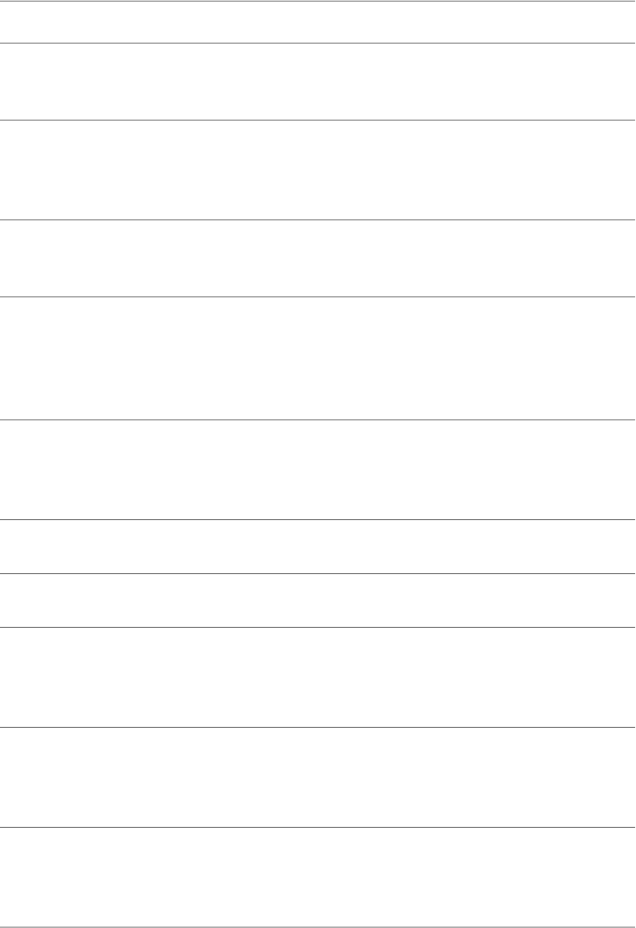
DescriptionKeyboard ShortcutUnwrap UVW Function
Hides the current selection
in the Edit UVWs dialog.
Ctrl+HHide Selected
When on you can select
only faces in the viewport
that are facing you.
Ignore Back Faces
Loads the UI defaults from
an .ini file.
Load Defaults
Lets you load a .uvw file
onto a mesh. The mesh
Alt+Shift+Ctrl+LLoad UVW
must have similar topology
as the source.
Locks the selection so you
cannot add to or remove
from it.
SpacebarLock Selected Vertices
Mapping Align Normals
Mapping Align To View
Aligns the mapping gizmo
to the X axis of the object's
local coordinate system.
Mapping Align X
Aligns the mapping gizmo
to the Y axis of the object's
local coordinate system.
Mapping Align Y
Aligns the mapping gizmo
to the Z axis of the object's
local coordinate system.
Mapping Align Z
Moves the mapping gizmo
so that its pivot coincides
Mapping Center
Unwrap UVW Modifier | 1811
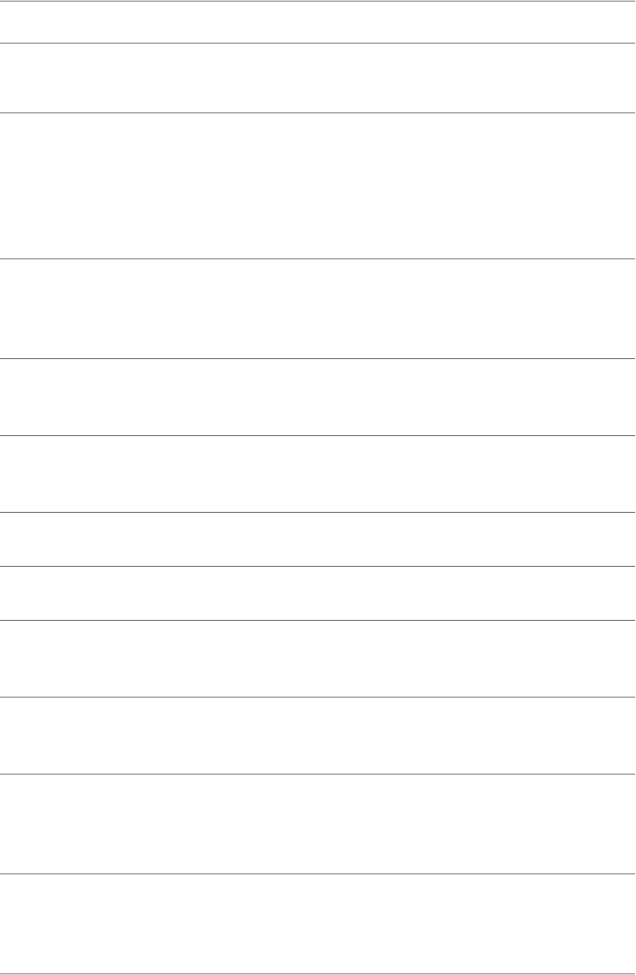
DescriptionKeyboard ShortcutUnwrap UVW Function
with the center of the selec-
tion.
Scales the gizmo to the ex-
tents of the selection and
Mapping Fit
centers it on the selection.
Does not change the orien-
tation.
Scales the gizmo to fit the
selection and aligns it with
the object's local space.
Mapping Reset
Mirrors the current selec-
tion along the U axis.
Alt+Shift+Ctrl+NMirror Horizontal
Mirrors the current selec-
tion along the V axis.
Alt+Shift+Ctrl+MMirror Vertical
Alt+Shift+Ctrl+JMove Horizontal
Alt+Shift+Ctrl+KMove Vertical
This creates a mapping
based on the face normals.
Normal Map
Opens a dialog for making
Normal Mapping settings.
Normal Map Dialog
When turned on, selecting
an open edge selects all at-
tached open edges.
Open Edge Mode
Selects all open edges con-
nected to the current selec-
tion.
Open Edge Select
1812 | Chapter 9 Modifiers
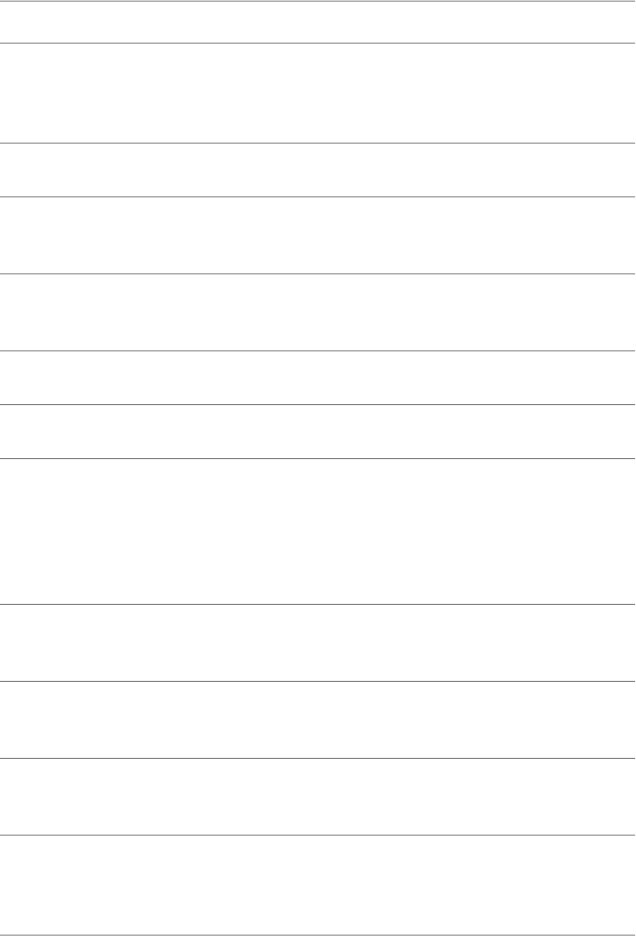
DescriptionKeyboard ShortcutUnwrap UVW Function
Lays out all selected ele-
ments so they don't over-
lap.
Pack
Opens the Pack dialog.Pack Dialog
Applies to the Sketch tool.Paint Select Decrement
Cursor Size
Applies to the Sketch tool.Paint Select Increment
Cursor Size
Applies to the Sketch tool.Paint Select Mode
Ctrl+PPan
Pastes the contents of the
paste buffer onto the selec-
Paste
tion. For best results the
source and target should
have similar topology.
The pasted and source UVs
will share the same vertices.
Paste Instance
Toggles display of the pelt
seams in the viewports.
Pelt Always Show Seams
Opens the Pelt Map Param-
eters dialog
Pelt Dialog
Mirrors the stretcher points
from one side of the mirror
axis to the other.
Pelt Dialog Mirror Stretcher
Causes a relatively strong
normalization of the dis-
Pelt Dialog Relax Simula-
tion Heavy
Unwrap UVW Modifier | 1813
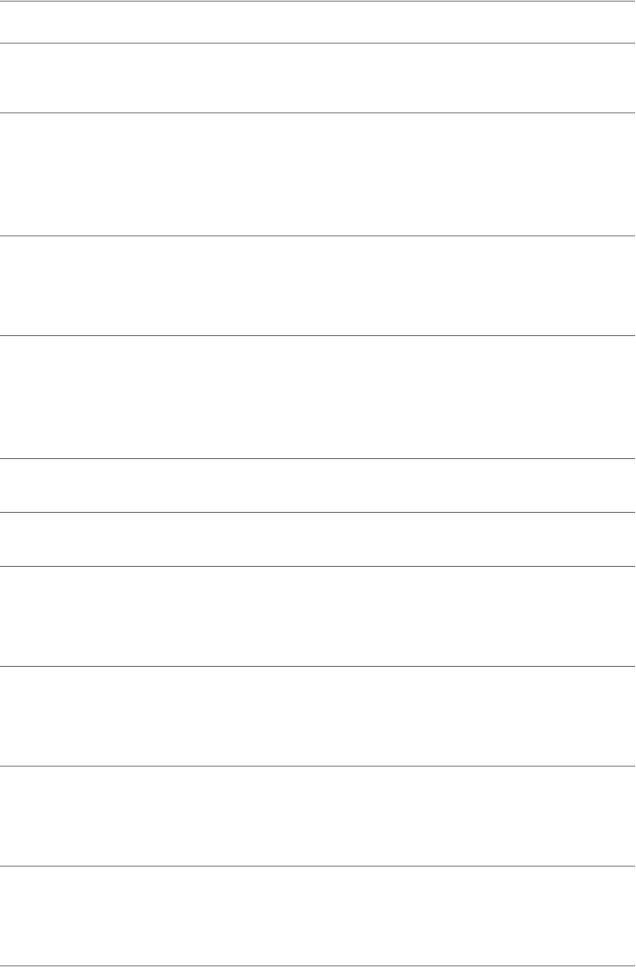
DescriptionKeyboard ShortcutUnwrap UVW Function
tances between mapping
vertices.
Causes a relatively weak
normalization of the dis-
Pelt Dialog Relax Simula-
tion Light
tances between mapping
vertices.
Returns the stretcher and
the pelt UVs to their default
shape and orientation.
Pelt Dialog Reset Stretcher
Runs the simulation,
pulling the pelt seam ver-
Pelt Dialog Run Simulation
tices towards the stretcher
points.
Selects all pelt UVs.Pelt Dialog Select Pelt UVs
Selects all stretcher UVs.Pelt Dialog Select Stretcher
Aligns all the stretcher
points to the edge seams
on the pelt UVs.
Pelt Dialog Snap Seams
Lets you specify a polygo-
nal outline for the stretcher
by moving points.
Pelt Dialog Straighten
Stretcher
Lets you specify a pelt seam
by selecting edges with the
mouse in the viewports.
Pelt Edit Seams
Expands the current face
selection to meet the pelt
seam border(s).
Pelt Expand Selection To
Seams
1814 | Chapter 9 Modifiers
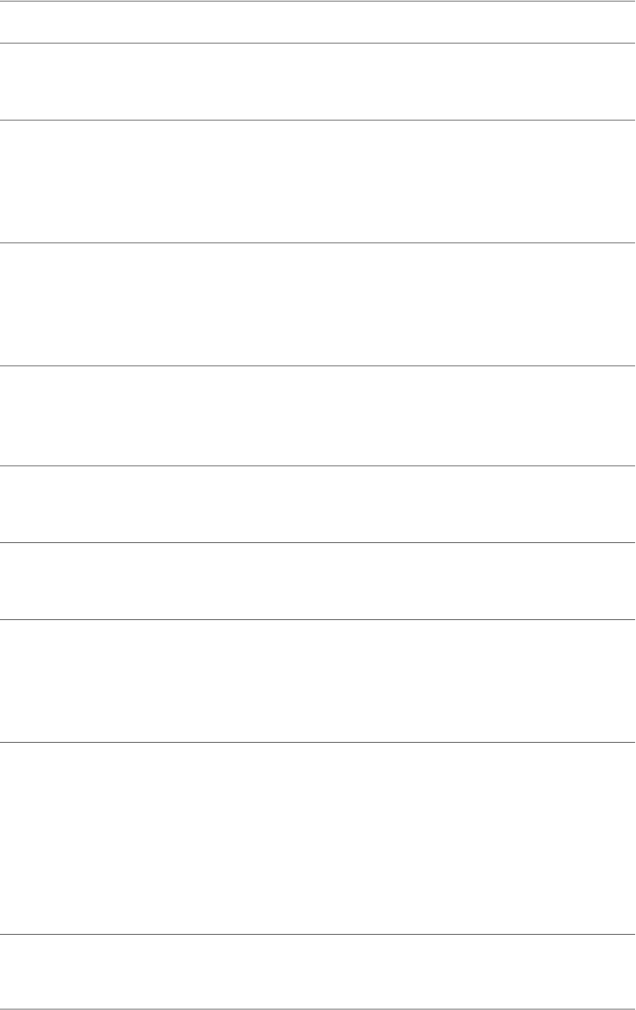
DescriptionKeyboard ShortcutUnwrap UVW Function
Activates pelt-mapping
mode.
Pelt Map
Converts the pelt seam to
an edge selection, adding
Pelt Seam to Edge Sel
(Add)
to the current edge selec-
tion.
Converts the pelt seam to
an edge selection, replac-
Pelt Seam to Edge Sel (Re-
place)
ing the current edge selec-
tion.
Snaps the Freeform gizmo
pivot to the specified giz-
mo edge.
Pivot Snap ... (nine short-
cuts)
Applies a planar map to the
current selection.
EnterPlanar Map Faces/Patches
Turns on the Modify panel
> Planar Angle check box.
Planar Threshold
Lets you specify pelt seams
by selecting vertices with
Point to Point Edge Selec-
tion
the mouse in the view-
ports.
Applies only to triangle
meshes. When turned on
Polygon Mode
(the default), if you select
a triangular face, the soft-
ware will select all faces
that belong to the poly
that owns that face.
Expands the current face
selection to the poly.
Polygon Select
Unwrap UVW Modifier | 1815
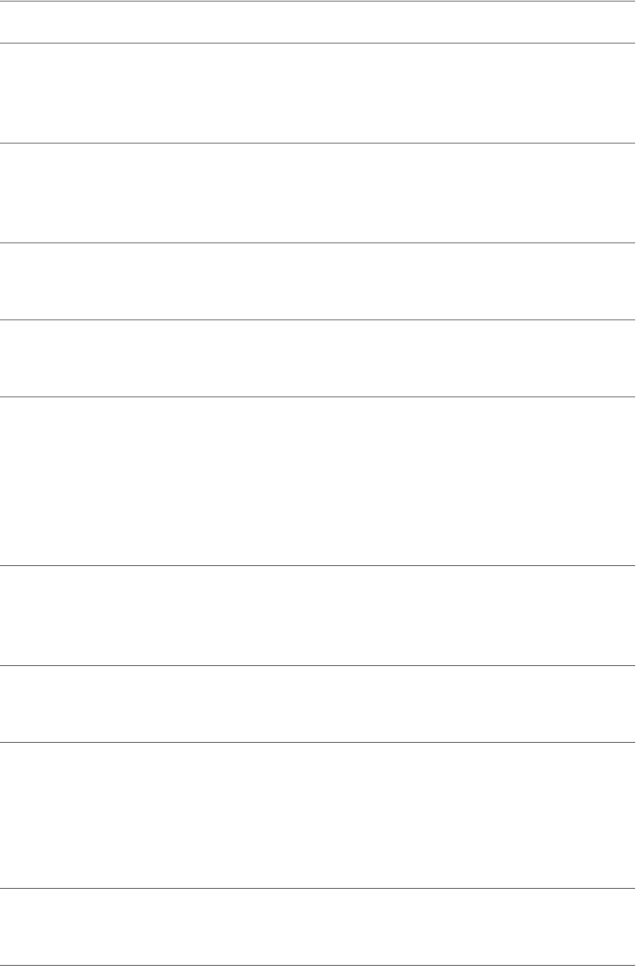
DescriptionKeyboard ShortcutUnwrap UVW Function
When on, keeps Render To
Texture from reflattening
the mapping.
Prevent Reflattening
Applies the default Relax
Tool settings to the current
texture vertex selection.
Relax
Opens the Relax Tool dia-
log.
Relax Dialog
Renders the UVW coordi-
nates to a bitmap.
Render UVW Template
When turned on (the de-
fault), the Freeform gizmo
Reset Pivot On Selection
pivot is reset to the center
every time the selection
changes, otherwise the
pivot maintains its offset.
Sets texture coordinates to
the original values before
Unwrap was applied.
Reset UVWs
Saves current UI values to
the default .ini file.
Save Current Settings As
Default
Lets you save the UVW data
to disk as a .uvw file, which
Save UVW
can be read in later or onto
another mesh if they have
similar topology.
Scales the selection along
the U axis.
Scale Horizontal
1816 | Chapter 9 Modifiers
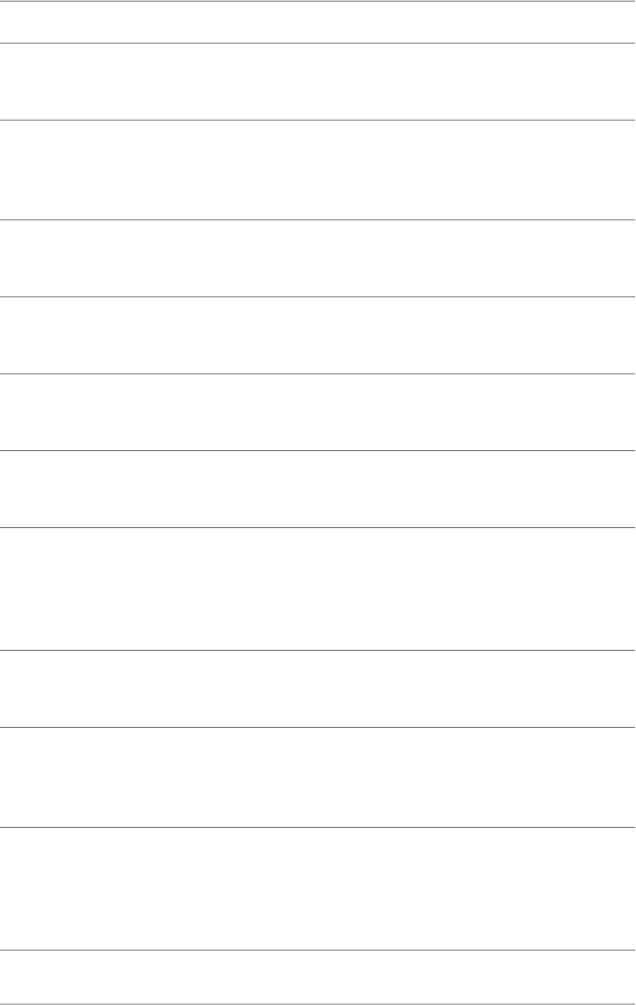
DescriptionKeyboard ShortcutUnwrap UVW Function
Scales the selection along
the V axis.
Scale Vertical
Selects any faces in the Edit
UVWs dialog that are not
facing you.
Select Inverted Faces
Selects overlapping faces in
the Edit UVWs dialog.
Select Overlapped Faces
Uses a green-to-red color
range to depict distortion.
Show Edge Distortion
Toggles display of all
edges.
Show Hidden Edges
Toggles display of the im-
age map.
Show Map
Toggles display of cluster
seams in the viewport.
Alt+EShow Seams in Viewport
Works only when Edit
UVWs dialog has focus.
Shows sub-objects that
share edges/vertices.
Show Shared Sub-objects
Displays the number of se-
lected objects in the editor
window.
Show Subobject Counter
Tags all texture vertices
that share the same geom-
Show Vertex Connections
etry vertex with a unique
ID.
Activates Sketch Vertices.Sketch
Unwrap UVW Modifier | 1817
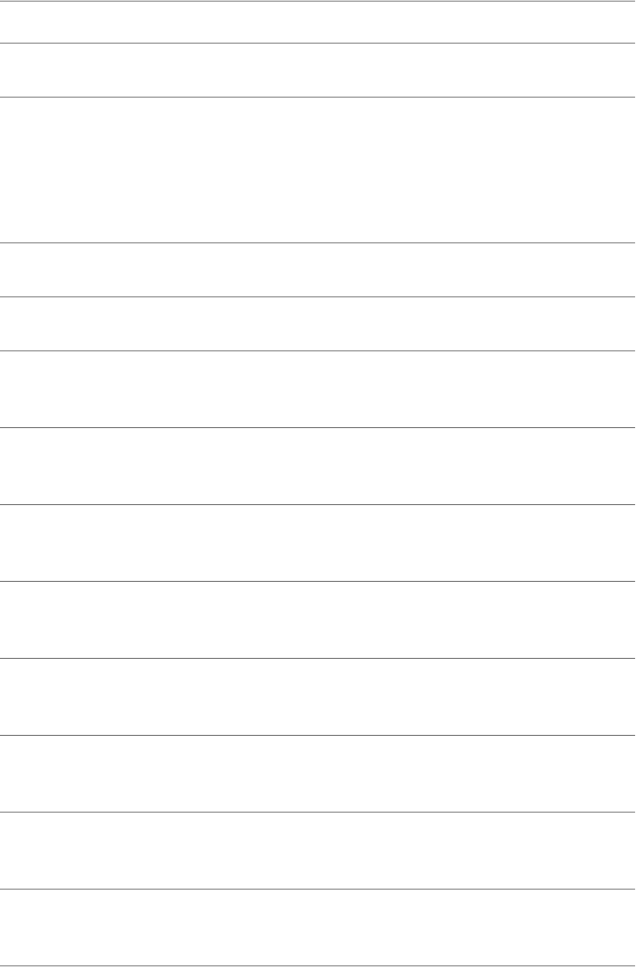
DescriptionKeyboard ShortcutUnwrap UVW Function
Sketch Dialog
Reverses the order of the
selected vertices for Sketch
Sketch Reverse Vertex Or-
der
mode. Applies to the Use
Current Selection option
for Sketch.
Toggles snapping.Ctrl+SSnap
Sets the snap type.Snap to Grid/Vertex/Edge
Equivalent to turning on
Edge Distance.
Soft Selection Edge Dis-
tance
Set Edge Distance to the
specified value.
Soft Selection Edge Dis-
tance Range 1
Set Edge Distance to the
specified value.
Soft Selection Edge Dis-
tance Range 2
Set Edge Distance to the
specified value.
Soft Selection Edge Dis-
tance Range 3
Set Edge Distance to the
specified value.
Soft Selection Edge Dis-
tance Range 4
Set Edge Distance to the
specified value.
Soft Selection Edge Dis-
tance Range 5
Set Edge Distance to the
specified value.
Soft Selection Edge Dis-
tance Range 6
Set Edge Distance to the
specified value.
Soft Selection Edge Dis-
tance Range 7
1818 | Chapter 9 Modifiers
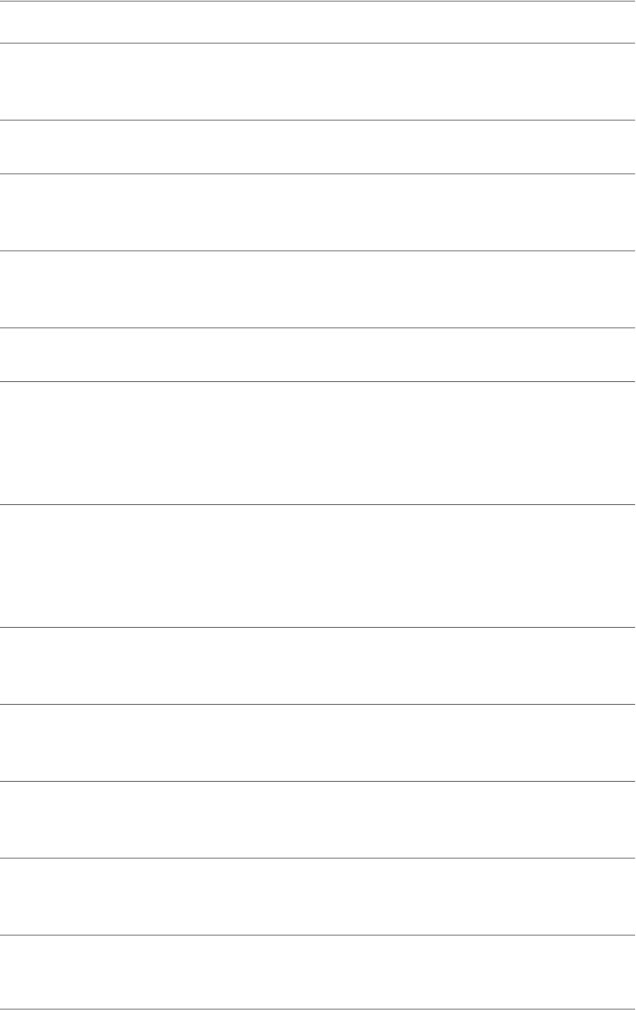
DescriptionKeyboard ShortcutUnwrap UVW Function
Set Edge Distance to the
specified value.
Soft Selection Edge Dis-
tance Range 8
Applies spherical mapping.Spherical Map
Stitches together shared
edges of a polygon.
Stitch
Opens the properties for
the Stitch command.
Stitch Dialog
Same as Sync to ViewportSync Selection Mode
Synchronizes the selection
in the Edit UVWs dialog to
Sync Texture Selection to
Viewport
the selection in the view-
port.
Synchronizes the selection
in the viewport to the selec-
Sync Viewport Selection to
Texture
tion in the Edit UVWs dia-
log.
Shrinks the selection in the
Edit UVWs dialog.
- (minus sign), - (on numer-
ic keypad)
Texture Vertex Contract
Selection
Grows the selection in the
Edit UVWs dialog.
= (equal sign), + (on numer-
ic keypad)
Texture Vertex Expand Se-
lection
Lets you move vertices in
editor.
QTexture Vertex Move Mode
Lets you rotate vertices in
editor.
Ctrl+RTexture Vertex Rotate
Mode
Lets you scale vertices in
editor.
Texture Vertex Scale Mode
Unwrap UVW Modifier | 1819
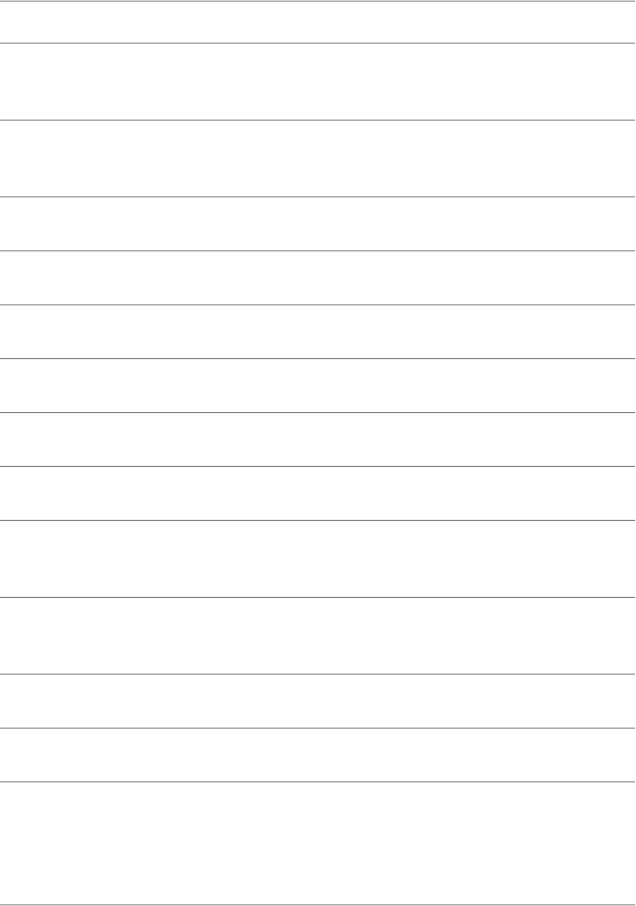
DescriptionKeyboard ShortcutUnwrap UVW Function
Welds selected vertices in
editor.
Ctrl+WTexture Vertex Weld Select-
ed
Lets you target-weld select-
ed vertices in editor.
Ctrl+TTexture Vertex Target Weld
TV=Texture VertexTV Edge Sub-object Mode
TV=Texture VertexTV Element Mode
TV=Texture VertexTV Face Sub-object Mode
TV=Texture VertexTV Vertex Sub-object Mode
Unfold Map
Unfold Map Dialog
Unfreezes all frozen ele-
ments.
Unfreeze All
Unhides all hidden ele-
ments.
Unhide All
Ctrl+O (letter "o")Unwrap Options
Updates map in editor.Ctrl+UUpdate Map
When on, selecting an
edge expands the selection
UV Edge Mode
to include all edges in its
loop on page 1797 .
Expands an existing edge
selection to include all
UV Edge Select
1820 | Chapter 9 Modifiers
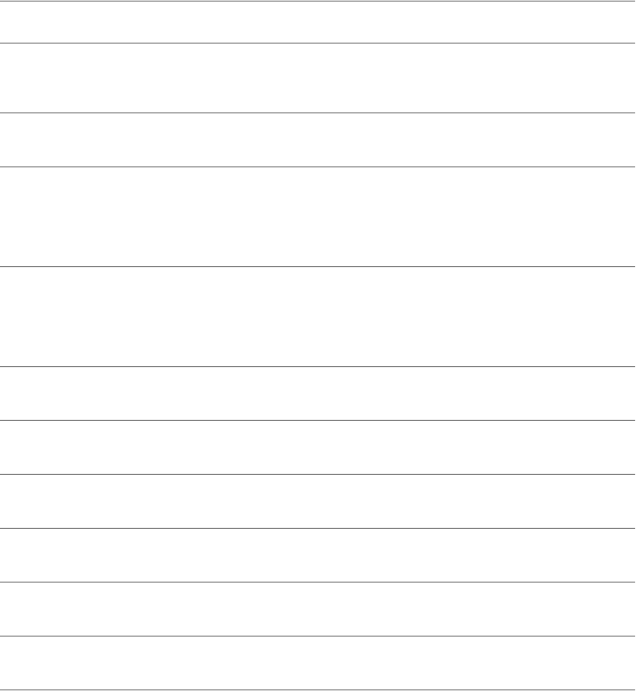
DescriptionKeyboard ShortcutUnwrap UVW Function
edges in its loop on page
1797 .
Vertex Snap
Converts vertex selection
to an edge selection and
puts you in Edge mode.
Vertex To Edge Select
Converts vertex selection
to a face selection and puts
you in Face mode.
Vertex To Face Select
ZZoom
XZoom Extents
Alt+Ctrl+ZZoom Extents Selected
Ctrl+XZoom Region
Zoom Selected Element
Shift+SpacebarZoom to Gizmo
UVW Editor Dialogs
Flatten Mapping Dialog
Select an object. > Modify panel > Modifier List > Object-Space Modifiers >
Unwrap UVW > Edit button (on Parameters rollout) > Mapping menu > Flatten
Mapping
The Flatten Mapping method of procedural mapping applies planar maps to
groups of contiguous faces that fall within a specified angle threshold. It
Unwrap UVW Modifier | 1821
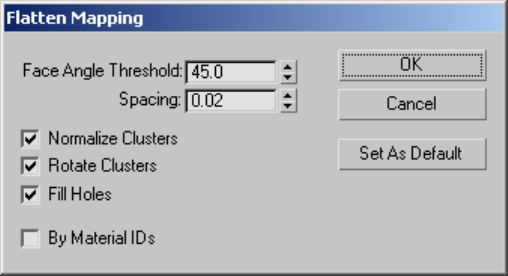
prevents overlap of mapping clusters, but can still cause texture distortion.
The Flatten Mapping dialog lets you control how clusters are defined and
mapped.
See also:
■Normal Mapping Dialog on page 1823
■Unfold Mapping Dialog on page 1843
Interface
Face Angle Threshold The angle used to determine the clusters to be mapped.
As the Flatten Map gathers faces to be mapped, it uses this parameter to
determine which faces get put in a cluster. This is the maximum angle that
can exist between faces in a cluster.
The higher this number, the larger the clusters will be, with consequently
greater distortion introduced as a result of texture faces' proportions deviating
from their geometry-equivalent faces.
Spacing Controls the amount of space between clusters.
The higher this setting, the larger the gap that appears between clusters.
Normalize Clusters Controls whether the final layout will be scaled down
to 1.0 unit to fit within the standard editor mapping area. If this is turned off,
the final size of the clusters will be in object space, and they'll probably be
much larger than the editor mapping area. For best results, leave this turned
on.
1822 | Chapter 9 Modifiers
Rotate Clusters Controls whether clusters are rotated to minimize the size
of their bounding box. For instance, the bounding box of a rectangle rotated
45 degrees occupies more area than one rotated 90 degrees.
Fill Holes When turned on, smaller clusters will be placed in empty spaces
within larger clusters to take the most advantage of the available mapping
space.
By Material IDs When on, ensures that no cluster contains more than one
material ID after flattening.
OK Accepts the settings, closes the dialog, and performs the mapping as
specified.
Cancel Undoes any changes and closes the dialog.
Set As Default Makes the current settings the defaults for the current session.
Normal Mapping Dialog
Select an object. > Modify panel > Modifier List > Object-Space Modifiers >
Unwrap UVW > Edit button (on Parameters rollout) > Mapping menu > Normal
Mapping
The Normal Mapping method of procedural mapping applies planar maps
based on different vector-projection methods. It is the most straightforward
method, but can result in even greater texture distortion than with Flatten
mapping on page 1821 . The Normal Mapping dialog lets you control how
clusters are defined and mapped.
See also:
■Flatten Mapping Dialog on page 1821
■Unfold Mapping Dialog on page 1843
Unwrap UVW Modifier | 1823
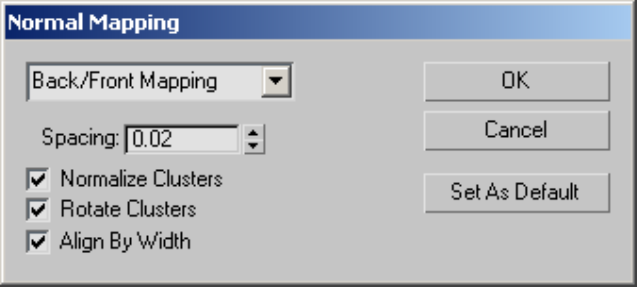
Interface
(drop-down) Sets the mapping method:
■Back/Front
■Left/Right
■Top/Bottom
■Box No Top
■Box
■Diamond
Spacing Controls the amount of space between clusters.
The higher this setting, the larger the gap that appears between clusters.
Normalize Clusters Controls whether the final layout will be scaled down
to 1.0 unit to fit within the standard editor mapping area. If this is turned off,
the final size of the clusters will be in object space, and they'll probably be
much larger than the editor mapping area. For best results, leave this turned
on.
Rotate Clusters Controls whether clusters are rotated to minimize the size
of their bounding box. For instance, the bounding box of a rectangle rotated
45 degrees occupies more area than one rotated 90 degrees.
Align By Width Controls whether the width or the height of the clusters is
used to control the layout of the clusters.
OK Accepts the settings, closes the dialog, and performs the mapping as
specified.
1824 | Chapter 9 Modifiers
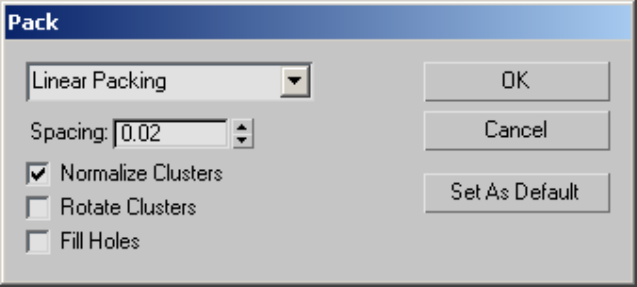
Cancel Undoes any changes and closes the dialog.
Set As Default Makes the current settings the defaults for the current session.
Pack UVs Dialog
Select an object. > Modify panel > Modifier List > Object-Space Modifiers >
Unwrap UVW > Edit button (on Parameters rollout) > Tools menu > Pack UVs
The Pack UVs dialog contains controls for clusters.
Interface
(drop-down) Sets the packing method:
■Linear Packing Uses a linear method to lay out the faces. This method is
fast but not very efficient, and tends to leave a lot of unused UV space.
■Recursive Packing Slower than the Linear method, but packs the faces
more efficiently.
Spacing Controls the amount of space between clusters.
The higher this setting, the larger the gap that appears between clusters.
Normalize Clusters Controls whether the final layout will be scaled down
to 1.0 unit to fit within the standard editor mapping area. If this is turned off,
the final size of the clusters will be in object space, and they'll probably be
much larger than the editor mapping area. For best results, leave this turned
on.
Unwrap UVW Modifier | 1825
Rotate Clusters Controls whether clusters are rotated to minimize the size
of their bounding box. For instance, the bounding box of a rectangle rotated
45 degrees occupies more area than one rotated 90 degrees.
Fill Holes When turned on, smaller clusters will be placed in empty spaces
within larger clusters to take the most advantage of the available mapping
space.
OK Accepts the settings, closes the dialog, and performs the packing as
specified.
Cancel Undoes any changes and closes the dialog.
Set As Default Makes the current settings the defaults for the current session.
Pelt Map Parameters Dialog
Unwrap UVW Modifier > Face sub-object level > Map Parameters rollout >
Pelt > Edit Pelt Map
The primary function of the Pelt Map Parameters dialog is to let you stretch
out the UVW coordinates into a flat, unified map that you can then use for
texturing. When the dialog is open, the stretcher appears in the Edit UVWs
dialog window as a circle of points, each of which is attached to a vertex on
a pelt seam. You can manipulate these vertices exactly as any other vertex in
the editor, selecting, rotating, moving, etc. Other special functions available
on the dialog let you straighten out stretcher vertices, snap them to the pelt
seams, and so on.
1826 | Chapter 9 Modifiers
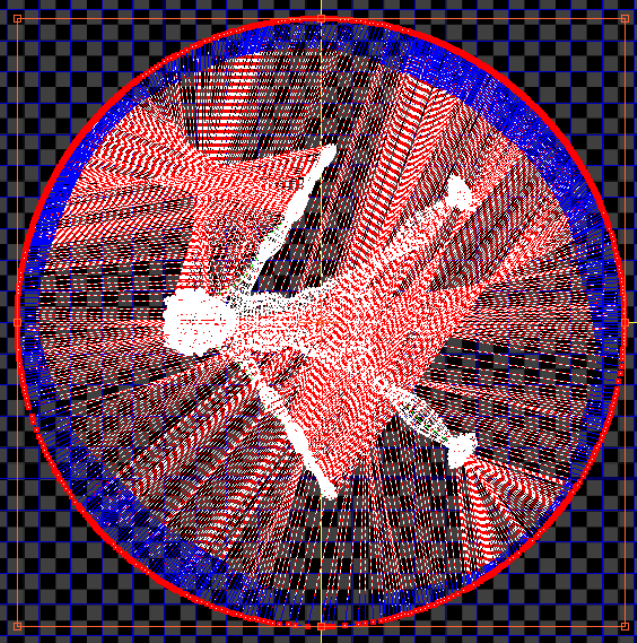
The stretcher points surround the pelt UVs in the Edit UVWs dialog window.
The lines connecting the stretcher vertices to the pelt-seam vertices function
as springs that pull the pelt seams outward in an animated simulation. After
you set up the pelt UVs and the stretcher shape, you run the simulation by
clicking the Simulate Pelt Pulling button. Depending on the results, further
adjustment and simulation might be required.
While Pelt mode is active and the Edit UVWs dialog is open, most standard
UVWs editing functions are also available. So, for example, instead of stretching
the entire pelt, you could select a subset of UVs to stretch. To access any
commands that are unavailable in Pelt mode, such as Mapping menu
commands, simply close the Pelt Map Parameters dialog.
Unwrap UVW Modifier | 1827
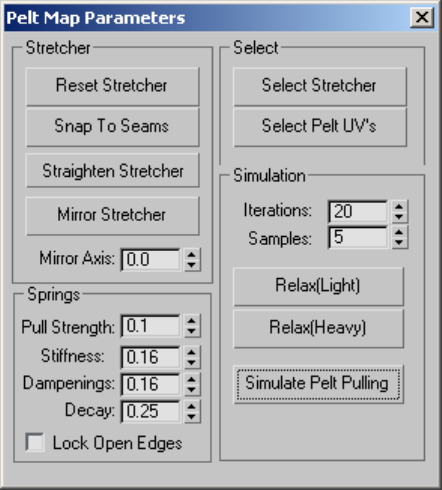
Interface
The primary Pelt Map commands are activated via the buttons in the
Simulation group. Other functions on this dialog let you adjust various
stretching parameters.
Stretcher group
These tools help adjust the stretcher shape.
Reset Stretcher Returns the stretcher and the pelt UVs to their default shape
and orientation, losing any stretching or editing of the stretcher or mapping
coordinates.
Snap To Seams Aligns all the stretcher points to the edge seams on the pelt
UVs. This causes the stretcher to take on the pelt outline.
For best results, use this command only after stretching.
Straighten Stretcher Lets you specify a polygonal outline for the stretcher
by moving points. When this mode is active, move one stretcher vertex, and
then move a second, non-adjacent point to line up all intervening vertices in
a straight line between the two. This process is fully interactive; as you move
1828 | Chapter 9 Modifiers
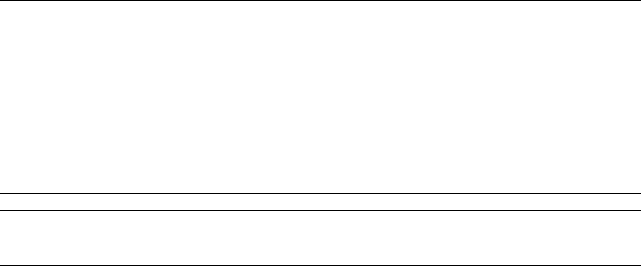
the second vertex, the intervening vertices continually change position to
maintain the straight line. Continue moving vertices to create a polygonal
outline; to quit, click Straighten Stretcher again.
NOTE While Straighten Stretcher is active, you can pan and zoom the editor
window at any time using contextual controls (middle-button drag or turn mouse
wheel, respectively) to access a different part of the window. After doing so, the
software still remembers the last vertex you dragged and draws a straight line
between it and the next one you drag. Similarly, you can adjust the window using
the control buttons on page 1794 and then return to straightening the stretcher.
If the control requires more than a single click, such as Pan, exit the control by
right-clicking in the window and then return to straightening the stretcher.
TIP To create a symmetrical outline for the stretcher, create the outline on one
side and then use Mirror Stretcher (following).
Mirror Stretcher Mirrors the stretcher points from one side of the mirror
axis (see following) to the other. By default, Mirror Stretcher mirrors the points
from the right side to the left.
Mirror Axis Lets you specify the orientation of the mirror axis. The axis takes
the form of three yellow lines forming a T. The leg of the T indicates the side
that will be mirrored when you use Mirror Stretcher (see preceding), and the
crossbar indicates the axis across which the mirroring will occur. Default=0.0.
Range=0.0 to 360.0.
Select group
These commands let you select all the stretcher points or the pelt UVs. As
with other selection methods, you can press and hold Ctrl when you use either
of these to add to the current selection. That is, to select all stretcher points
and pelt UVs, click one button, press and hold Ctrl, and then click the other
button.
Select Stretcher Selects all stretcher points.
Select Pelt UVs Selects all pelt UVs.
Springs group
These parameters control the springs that are used to stretch the pelt. In most
cases you won’t need to change these values, except possibly for Pull Strength.
Pull Strength The magnitude of the stretching action when you click Simulate
Pelt Pulling. Default=0.1. Range=0.0 to 0.5.
Unwrap UVW Modifier | 1829
If the stretching is too gradual, increase Pull Strength for a more forceful
stretching action.
Stiffness Sets the rate at which the springs pull. The higher the Stiffness
value, the more abrupt the pulling action. Default=0.16. Range=0.0 to 0.5.
Dampening Applies a dampening or inhibiting factor to the pulling action.
The higher the Dampening value, the greater the inhibition of the stretcher.
Default=0.16. Range=0.0 to 0.5.
Decay The rate of falloff of the influence of each pelt-seam vertex on the
other mapping vertices. Higher Decay values typically result in significantly
greater stretching, or undesirable results. For best results, keep the Decay value
low. Default=0.25. Range=0.0 to 0.5.
Lock Open Edges Locks the open edges in place. This typically applies to
using the stretcher on a partial selection of mapping vertices in the pelt region.
When Lock Open Edges is on, selected vertices next to unselected vertices
tend to stay in place during stretching. When Lock Open Edges is off, the
selected vertices tend to pull away from the unselected vertices.
Simulation group
These are the main controls for the simulation, in which the springs attached
to the stretcher pull the pelt seam vertices out, flattening the UVs. For best
results, alternate between running the simulation (click Simulate Pelt Pulling)
and relaxing the mesh.
Iterations The number of times the simulation will run through when you
click Simulate Pelt Pullings. Default=20. Range=1 to 100.
Often, you'll need to run repeated simulations to get the desired result.
Samples The number of samples around each pelt-seam point used in the
simulation. A higher value results in a greater pulling effect. Default=5. Range=1
to 50.
Relax (Light) Causes a relatively weak normalization of the distances between
mapping vertices.
Relax (Heavy) Causes a relatively strong normalization of the distances
between mapping vertices.
Simulate Pelt Pulling Runs the simulation, pulling the pelt seam vertices
towards the stretcher points. To abort the simulation process, press Esc.
1830 | Chapter 9 Modifiers
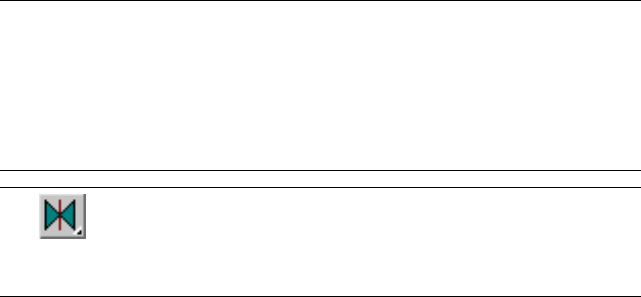
Relax Tool Dialog
Select an object. > Modify panel > Modifier List > Object-Space Modifiers >
Unwrap UVW > Edit button (on Parameters rollout) > Edit UVWs dialog >
Make a selection. > Tools menu > Relax Dialog
The Relax Tool dialog offers an advanced toolset for modifying the spacing
of selected texture coordinates parametrically, for the purpose of eliminating
or minimizing distortion in texture maps. The dialog provides three different
methods for relaxing vertices, plus several numeric parameters and two check
boxes. You can use Relax to separate texture vertices that are too close together
to texture easily, and to resolve overlapping areas.
The dialog is non-modal, which means that you can work directly in the editor
while keeping the dialog open. You can make a selection of texture vertices,
apply relaxation, make a different selection, apply relaxation, and so on,
without having to close the Relax Tool dialog.
TIP When using Relax with complex objects, you might find that vertices in interior
sections of the texture mesh don't relax properly because they have nowhere to
go. In such cases, try making a seam: Select an edge loop or part of a loop, and
then use the Break on page 1802 function to separate the mesh at the seam.
Alternatively, you could make a face selection and then use Detach Edge Verts.
For example, Select Overlapped Faces > Expand Selection > Detach Edge Verts
will break the selection away from the mesh into a new UV element.
TIP Effective use of the Relax tools requires that the geometry and texture
vertices be in the same order. If you get unexpected results using Relax, try
mirroring the texture vertices to reverse their order.
Procedures
To relax texture coordinates:
1Use the Edit UVWs dialog to select the texture-coordinate vertices to
relax.
You can make this selection at any sub-object level (Vertex, Edge, or Face),
but Relax always works on vertices.
2On the Tools menu, choose Relax Dialog.
Unwrap UVW Modifier | 1831
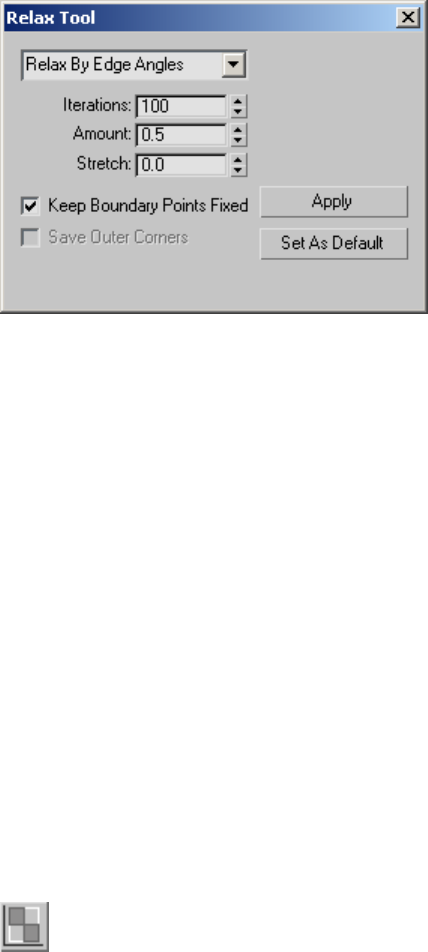
This opens the Relax Tool dialog.
3Choose the relax method. Three are available from the drop-down list:
■Relax By Face Angles
■Relax By Edge Angles
■Relax By Centers
The default method is Relax By Edge Angles; this most often gives the
best results.
4Set the other options and then click Apply.
As the relaxing progresses, a message appears showing you which frame
is being processed. A frame is equivalent to an iteration.
The appropriate method and other settings to use depend on a variety
of conditions, including the complexity and topology of the mesh, so
experimentation is usually required. Relaxing is undoable, so if one
method doesn't work, undo and try another.
To use Relax to fix overlapping faces:
This procedure provides general guidelines for resolving overlapping texture
faces. It might not work in every case, but it should give you a starting point
for correcting most situations.
1 Open the Edit UVWs dialog and in the Selection Modes group,
click Face Sub-object Mode.
1832 | Chapter 9 Modifiers
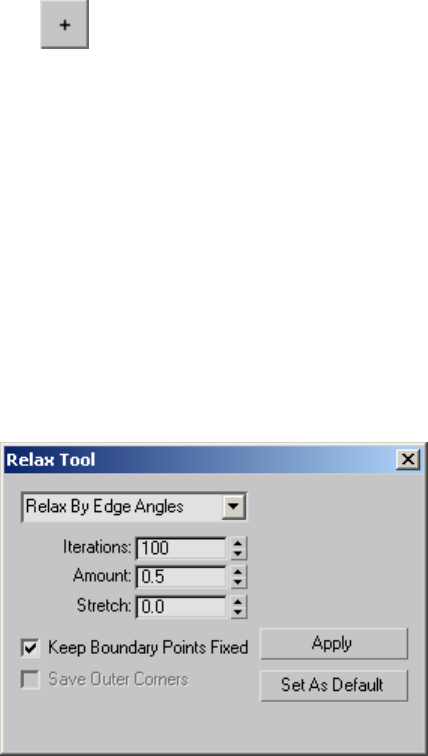
2From the Edit UVWs dialog > Select menu, choose Select Overlapping
Faces.
Only the overlapping faces are selected.
3 Click Expand Selection to select faces surrounding the overlapping
faces.
This gives the overlapping faces a larger area in which to spread out.
4From the Tools menu, choose Relax Dialog.
5On the Relax Tool dialog, set Stretch to an intermediate value. If the
overlapping is considerable, use 0.5 or higher. If it's relatively small, try
0.1 to 0.3.
6Click Apply.
If this seems to be helping, continue clicking Apply until the overlapping
is resolved. If not, undo (Ctrl+Z) and try using Relax By Face Angles
instead, or increase the Amount value, or change the Stretch value, or
use combinations of the above.
Interface
[relax method] The method used to relax the texture vertices. Choose from
the drop-down list:
■Relax By Face Angles Relaxes the vertices based on the shape of the faces.
It tries to align the geometric shape of the face to the UV face. This
Unwrap UVW Modifier | 1833
algorithm is mainly used to remove distortion and not so much to remove
overlap, and is best suited for simpler shapes.
■Relax By Edge Angles This default method is similar to Relax By Face
Angles except that it uses the edges that are attached to the vertices as the
shape to match. It typically works better than Relax By Face Angles but
tends to take longer to reach a solution. This method is bested suited for
more complex shapes.
■Relax By Centers The original Relax method from previous versions of
3ds Max. It relaxes vertices based off the centroids (centers of mass) of their
faces. It does not take into account the face or edge shapes/angles so it is
mainly useful for removing overlap or for faces that are mostly rectangular.
Iterations The number of times the Relax settings are applied when you click
Apply. Each iteration is applied successively, to the results of the previous
iteration. Range=0 to 100000. Default=100.
Amount The strength of the relaxation applied per iteration. Range=0.0 to
1.0. Default=0.1.
Stretch The amount of stretching that can occur. Stretching is useful mainly
to resolve overlapping texture vertices, at the cost of reintroducing distortion
into the texture mesh. Range=0.0 to 1.0. Default=0.0.
Keep Boundary Points Fixed Controls whether vertices at the outer edges of
the texture coordinates are moved. Default=off.
When off, the outer edge of the texture mesh can float, allowing a wider range
of the available texture-mapping space to be used. Typically you would keep
this off when relaxing an entire element or cluster, so the software can
minimize distortion by moving the edges.
When relaxing an interior subset of vertices, it is recommended you turn this
on to prevent the selected vertices from overlapping unselected vertices. For
Relax By Edge and Face Angles, turn this off until you get a good solution for
the outer boundaries of the mesh and then turn it on to resolve the interior
sections.
Save Outer Corners Preserves the original positions of texture vertices farthest
away from the center. Available only with the Relax By Centers method.
Apply Begins the relaxation process using the current settings. As relaxation
takes place, a textual progress indicator appears at the bottom of the dialog,
showing the current iteration (Process frame) and the total number of iterations
being processed.
1834 | Chapter 9 Modifiers
To abort the relaxation process, press Esc. You can then use Undo (Ctrl+Z) to
return to the prior state, if necessary.
Set As Default Saves all current settings as the Relax defaults, so they are
recalled from session to session.
Render UVs Dialog
Unwrap UVW modifier > Edit button (on Parameters rollout) > Tools menu
> Render UVW Template
The Render UVs dialog, part of the Unwrap UVW editor on page 1788 , lets you
export a model's texture mapping data as a template; a bitmapped image file.
you can then import this template into a 2D paint program, apply color as
needed, and then bring it back into 3ds Max as a texture map to apply to the
model. The exported file looks like a screen shot of the editor window, but
without any background texture, and has the added options of setting color
and alpha options for both the edges and the area they cover.
For a procedure that covers usage of this dialog, see To export texture
coordinates to a paint program: on page 1777 .
Unwrap UVW Modifier | 1835
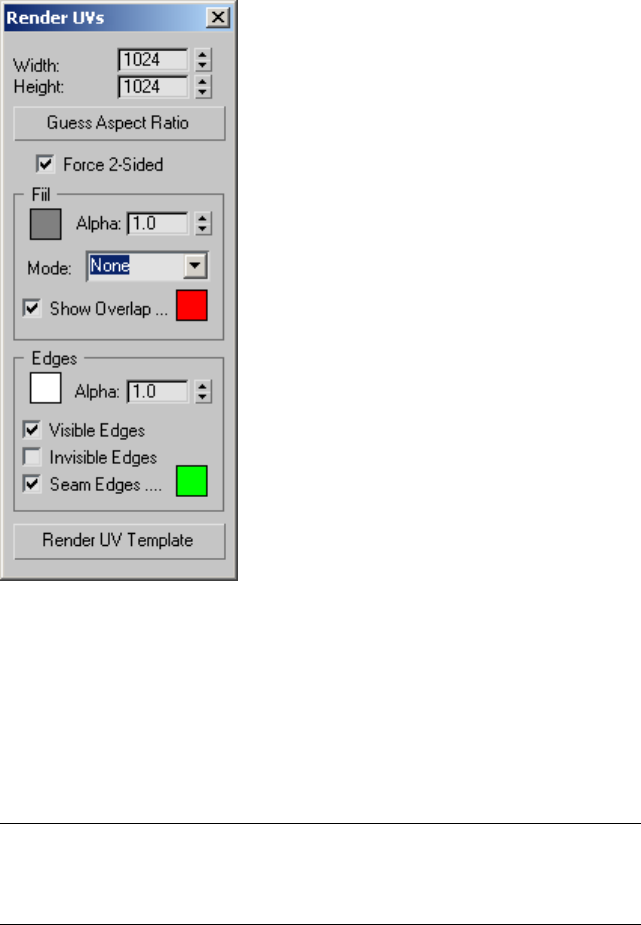
Interface
Width/Height The horizontal and vertical dimensions of the output
(rendered) template image in pixels.
Guess Aspect Ratio Adjusts the Height value to produce an output aspect
ratio based on the Width value and the dimensions of the UV grid.
For instance, if a rectangular UV grid measures 20 x 100 units and you click
Guess Aspect Ratio, it would try to keep the bitmap at the 1:5 aspect ratio.
This makes painting on the bitmap easier because the bitmap is at the correct
aspect ratio for the mesh.
WARNING Using this function can result in Height value that is not a power of
2. If your mesh is destined for a real-time renderer, adjust the resulting Height
value to the nearest power of 2 after using Guess Aspect Ratio. For example, if it
sets Height to 650, change it to 512 before rendering the template.
1836 | Chapter 9 Modifiers

Force 2-Sided When on, all UV edges are rendered into the template. When
off, only UV edges of faces facing the viewer are included; edges of back-facing
faces are not rendered.
Fill group
Fill is the coloring applied to the rendered bitmap in the face areas between
edges. By default, there's no fill; the bitmap color is black, and the alpha
channel is fully transparent. You can change this to a solid color or to shading
derived from the mesh and lighting in the scene, or from the normal directions.
NOTE The overlap color overrides the fill color. For example, if Show Overlap is
on and all visible faces overlap other faces, all faces will show the overlap color,
ignoring the fill color.
[color swatch] Shows the fill color used for faces when Mode is set to Solid.
To change the color, click the swatch.
Alpha Sets the alpha-channel value for the fill areas when Mode=Solid,
Normal, or Shaded. When Mode=None, the fill alpha is always 0.0
(transparent). Range=0.0 (transparent) to 1.0 (opaque). Default=1.0.
The alpha channel is included with the rendered image only when you save
in a format that supports transparency, such as TIF or Targa.
Mode Specifies the method used for filling faces in the rendered template.
■None: No fill is rendered. This setting ignores the Alpha value, and sets
fill alpha to 0.0; that is, fully transparent.
■Solid: Renders faces using the fill color specified by the swatch at the top
of the Fill group.
■Normal: Renders each vertex’s normals into the bitmap. The result looks
similar to a normal map.
■Shaded: Uses a simple lighting setup to render shading across the UV
surface.
Show Overlap When on, fills faces that overlap other faces with the overlap
color, shown in the color swatch to the right. Default=on.
To change the overlap color, click the color swatch.
Unwrap UVW Modifier | 1837
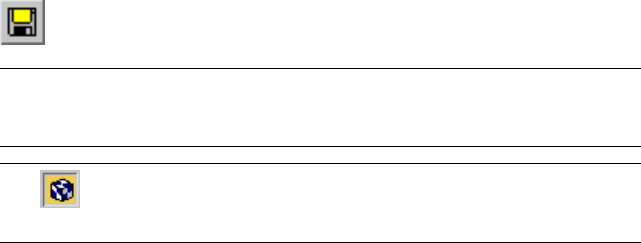
Edges group
[color swatch] Shows the color used for rendered edges. To change the color,
click the swatch.
Alpha Sets the alpha-channel value for edges. Range=0.0 (transparent) to
1.0 (opaque). Default=1.0.
The alpha channel is included with the rendered image only when you save
in a format that supports transparency, such as TIF or Targa.
Visible Edges When on, edges are rendered using the specified edge color.
Default=on.
Invisible Edges When on, hidden edges are rendered using the specified edge
color. Default=off.
Hidden edges are most often found dividing mesh polygons into triangles.
They aren't present in polygon objects.
Seam Edges When on, seam (outside) edges are rendered using the specified
seam color. Default=on.
To change the seam color, click the color swatch. The default color (green) is
the same as that used for seam edges in the Edit UVWs dialog, but the two
can be changed separately.
Render UV Template Renders the template bitmap in a new rendered frame
window on page 5885 .
To save the rendered frame, click the Save Bitmap button.
NOTE This command renders the normalized UV space, from (0,0) to (1,1), as
depicted in the editor by a dark blue outline. For best results, make sure the texture
UVs fill this space but don't exceed its bounds.
TIP To turn off the background texture, which tends to obscure the UV
space outline, click the Show Map button on the upper toolbar.
1838 | Chapter 9 Modifiers

Sketch Tool Dialog
Select an object. > Modify panel > Modifier List > Object-Space Modifiers >
Unwrap UVW > Edit button (on Parameters rollout) > Tools menu > Sketch
Vertices
If you need to match a contiguous selection of texture vertices to an outline
in a bitmap, whether an irregular shape, a straight line, or a geometric shape,
you can use the Sketch tool to perform the operation quickly, rather than
dragging the vertices one at a time.
Procedures
Example: To sketch texture vertices free form:
You can start with the vertices already selected, or use the Sketch tool to select
them. In this example, we'll assume the latter.
1Choose Sketch Vertices.
2In the Sketch Tool dialog, next to Select By, choose Drag Selection, if
necessary.
3Next to Align To, choose Free Form, if necessary.
4Make sure Show Vertex Order and Interactive Mode are turned on. Leave
Drag Cursor Size at the default setting.
5Click OK to close the dialog.
The mouse cursor takes the form of a circle, which means you're in “drag
select” mode.
6In the editor window, drag the cursor over the vertices to select, and then
release the mouse button.
As you drag, each vertex is assigned a consecutive number. When you
release the mouse button, the cursor turns into a pencil, which means
you're in “sketch” mode.
NOTE Before you start sketching, each successive mouse click alternates
between drag and sketch modes.
7In the editor window, drag a wavy line.
The selected vertices follow the line in numeric order, spreading out
evenly over its length. To start the sketch over, release the mouse button,
and then drag again.
Unwrap UVW Modifier | 1839
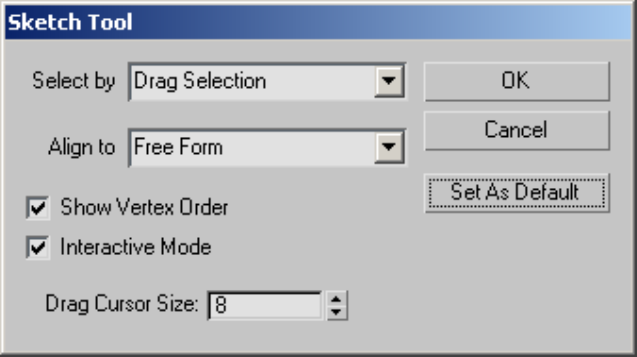
Alternatively, if you press and hold Alt, and then press and release the
mouse button, you'll draw a straight line by moving the mouse. Click
and move again to draw connected straight-line segments.
You can combine free-form and straight-line sketching freely:
■To append a free-form line to a straight-line segment, release the Alt
key and then begin dragging.
■To append a straight-line segment to a free-form line, press and hold
Alt as you drag, and then release the mouse button and move the
mouse.
8To exit the Sketch tool, right-click in the editor window.
Interface
Select by Lets you choose how to select the vertices to sketch:
■Pick Selection Lets you pick the vertices one by one. When you click OK,
a Pick cursor appears comprising a + sign and the letter P; when the cursor
is over a vertex, the + sign becomes larger. To finish picking, right-click,
and then drag to sketch. After sketching, you return to Pick mode, and so
on. To exit, right-click.
■Drag Selection Lets you pick multiple vertices by dragging. When you
click OK, the mouse cursor appears as a circle. After you drag to select
vertices, release the mouse button, and then drag (or Alt+click) to sketch.
1840 | Chapter 9 Modifiers
As with Pick Selection, the mouse cursor continues to alternate between
Select and Sketch modes until you right-click to exit.
■Use Current Selection Uses the current selection; you cannot change the
selection while using the tool. If the current selection is edges or faces,
Sketch uses all vertices attached to selected sub-objects.
Align To Lets you choose how to sketch:
■Free Form Drag to sketch free form (like drawing with a pencil), or
Alt+click to sketch connected
■Line Drag to sketch a single, straight line segment.
■Box Drag diagonally to sketch a rectangle.
■Circle Drag outward to sketch a circle, and then move the mouse in a
circle to rotate the circle.
Show Vertex Order Displays numbered labels that indicate the order in
which vertices were selected and will spread out during sketching.
Interactive Mode Shows vertex positioning as you sketch. Turn off for faster
feedback.
Drag Cursor Size Sets the size of the mouse cursor used while dragging a
selection. Default=8. Range=1 to 15.
OK Accepts the changes and closes the dialog.
Cancel Undoes any changes and closes the dialog.
Set As Default Makes the current settings the defaults for the current session.
Stitch Tool Dialog
Select an object. > Modify panel > Modifier List > Object-Space Modifiers >
Unwrap UVW > Edit button (on Parameters rollout) > Tools menu > Stitch
Selected
After you've separated your object's UVW coordinates into clusters, either
manually or using one of the automatic tools on the Mapping menu on page
1803 , you can use the Stitch tool to recombine specific clusters by merging
corresponding edges.
Unwrap UVW Modifier | 1841
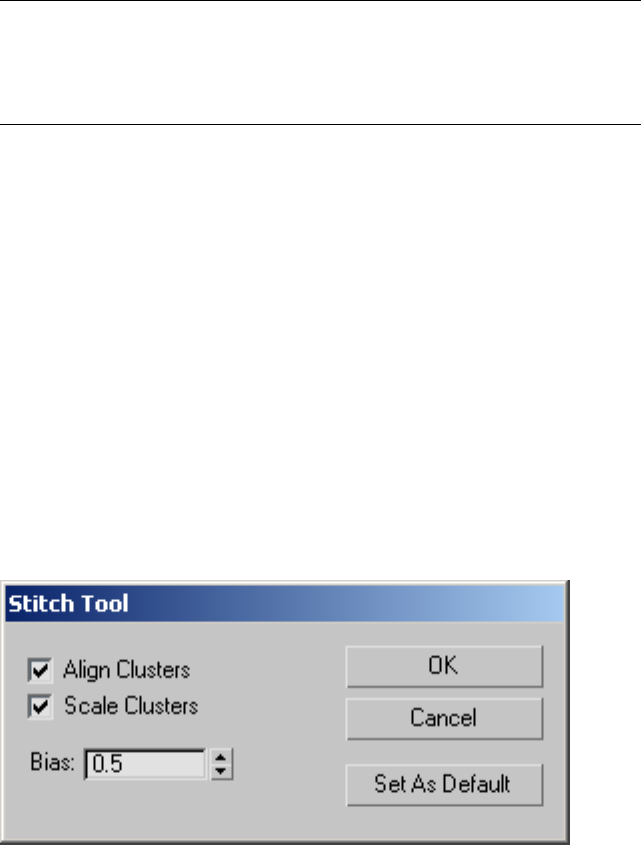
NOTE You can stitch together only two clusters at a time. If the current sub-object
selection is shared by more than one cluster, then “majority rules”: Stitch attaches
the cluster that shares the most sub-objects. If the number of sub-objects shared
by multiple other clusters is the same, the software attaches the cluster whose
shared sub-objects were chosen first.
Procedures
To stitch two clusters together:
1In the “source” cluster, select sub-objects along an edge you want to
connect.
By default, this causes the shared edges to highlight in the “target”
object(s).
2Choose Stitch Selected.
The clusters are connected.
3Adjust the settings on the Stitch Tool dialog.
Feedback takes place in real time.
4Click OK to accept or Cancel to abort.
Interface
Align Clusters Moves the target cluster to the source cluster, and rotates the
target cluster into place if necessary. When off, the target cluster remains in
its original position and orientation. Default=on.
1842 | Chapter 9 Modifiers
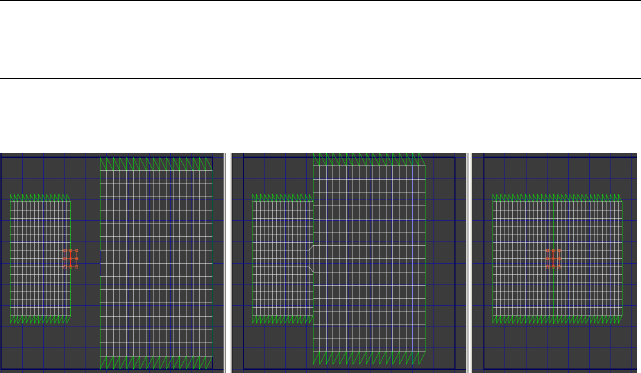
TIP If your clusters overlap after stitching with Align Clusters turned on, cancel
the stitching, and then position and align them as you want them after stitching.
Then use the Stitch tool with Align Clusters turned off.
Scale Clusters Resizes the target cluster to a size comparable to that of the
source cluster. Takes effect only when Align Clusters is on. Default=on.
Edges chosen to stitch (left); Clusters aligned (center); Clusters aligned and scaled,
with Bias=0 (right)
Bias When Scale Clusters is off, Bias sets the extent to which attached
sub-objects are moved from their original positions. At Bias=0, the sub-objects
remain in their original positions in the source cluster. At Bias=1, sub-objects
remain in their original positions in the target cluster. At in-between settings,
their positions are averaged between the two.
When Scale Clusters is on, Bias sets where the software derives the scaling of
the target cluster(s). At Bias=0, the scale is fully derived from the stitched edges
on the source. At Bias=1, the scale is fully derived from the stitched edges on
the target. At in-between settings, the scaling is averaged between the two.
OK Accepts the changes and closes the dialog.
Cancel Undoes any changes and closes the dialog.
Set As Default Makes the current settings the defaults for the current session.
Unfold Mapping Dialog
Select an object. > Modify panel > Modifier List > Object-Space Modifiers >
Unwrap UVW > Edit button (on Parameters rollout) > Mapping menu > Unfold
Mapping
Unwrap UVW Modifier | 1843
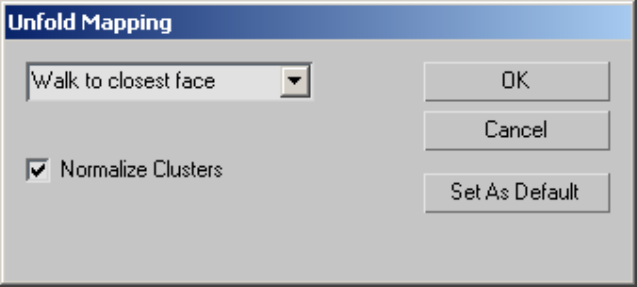
The Unfold Mapping method of procedural mapping eliminates texture
distortion, but can result in overlapping coordinate clusters. The Unfold
Mapping dialog lets you control how faces are unfolded.
See also:
■Flatten Mapping Dialog on page 1821
■Normal Mapping Dialog on page 1823
Interface
(drop-down) Sets the unfold method by specifying whether the software
will start unfolding with the closest or farthest face angle, with respect to
distance. In almost all cases, you'll get better results with Walk To Closest
Face.
■Walk To Closest Face
■Walk to Farthest Face
Normalize Clusters Controls whether the final layout will be scaled down
to 1.0 unit to fit within the standard editor mapping area. If this is turned off,
the final size of the clusters will be in object space, and they'll probably be
much larger than the editor mapping area. For best results, leave this turned
on.
OK Accepts the settings, closes the dialog, and performs the mapping as
specified.
Cancel Undoes any changes and closes the dialog.
1844 | Chapter 9 Modifiers
Set As Default Makes the current settings the defaults for the current session.
Unwrap Options Dialog
Select an object. > Modify panel > Modifier List > Object-Space Modifiers >
Unwrap UVW > Edit button (on Parameters rollout) > Edit UVWs dialog >
Options menu > Advanced Options
Set preferences for the Unwrap UVW editor using controls in the Unwrap
Options dialog.
Unwrap UVW Modifier | 1845
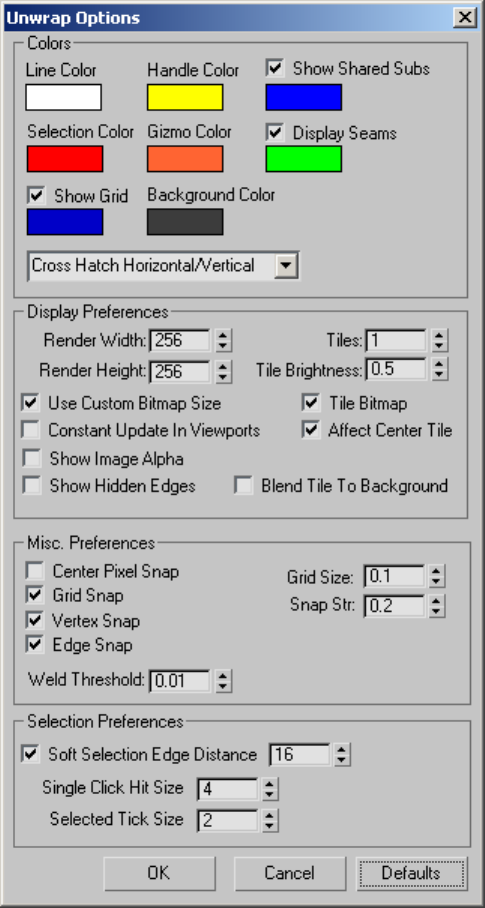
Interface
1846 | Chapter 9 Modifiers
Colors group
Contains color swatches to customize the display of the UVW lattice. With
certain maps, the default colors may become difficult to see. Use these swatches
to choose colors that work better for your specific map.
To change a color, click its swatch, and then use the Color Selector on page
331 to choose a new one.
Line Color Specifies the color of the UVW lattice lines. Default=white.
Handle Color The color assigned to patch handles. Default=yellow.
Show Shared Subs When turned on, non-selected sub-objects shared by the
current selection are highlighted in this color. In most cases, the shared
sub-objects are edges. With a single vertex, the shared sub-objects are vertices.
Defaults=on, blue.
Selection Color Specifies the color of selected UVW sub-objects. Default=red.
Gizmo Color The color assigned to the Freeform gizmo on page 1790 .
Default=orange.
Display Seams When on, lets you assign a distinctive color to coordinate
clusters' boundaries that appears in the viewports. Defaults=on, green.
Show Grid When on, the grid lines are visible. Defaults=on, dark blue.
You can also set the grid size on page 1849 .
Background Color The color assigned to the background where the texture
map isn't displayed. Default=dark gray.
(drop-down) Lets you assign a fill pattern to selected faces. Default=Cross
Hatch Horizontal/Vertical.
Display Preferences group
Contains controls affecting the map display in the view window.
Render Width Specifies the width resolution of the image displayed in the
view window. This does not change the size of the image, but only the
resolution.
Render Height Specifies the height resolution.
Use Custom Bitmap Size When turned on, scales the bitmap texture to the
values specified by Width and Height. You can adjust these settings to scale
and reproportion the bitmap texture in relation to the texture coordinates.
Unwrap UVW Modifier | 1847

This scaling doesn't affect the bitmap in the material, but only as viewed in
the editor.
TIP When working with large textures, reduce the bitmap size for faster feedback.
And when working with disproportionate textures, setting the dimensions closer
to each other in the editor can make it easier to work.
Tiles The number of times the texture image is repeated, counting outward
in eight directions (the four corners and the four sides).
With Tiles=1, the result is a 3 x 3 grid. With Tiles=2, the result is a 5 x 5 grid,
and so on.
You can toggle the tiling feature with the Tile Bitmap check box, described
below.
Tile Brightness Sets the brightness of the tiled bitmap. At 1.0, the brightness
equals that of the original image; at 0.5 it's half the brightness; and at 0, it's
black.
This is the same setting as Brightness in the UVWs editor > Bitmap Options
group (available with Show Options).
Tile Bitmap When turned on, you can repeat the bitmap in the editor,
displaying tiling set in the material.
You can use any part of the tiled image for setting texture coordinates. This
is helpful when the sections of the texture image are packed tightly together
and the mesh contains many different areas to map.
Affect Center Tile When turned on, the Brightness setting affects all tiles
equally. When off, the center, or “home,” tile always remains at full brightness,
so you can easily distinguish the home tile from the copies.
Constant Update in Viewports Affects the adjusting of UVW vertices in the
viewport while you move the mouse. Default=off (the effect of adjusting the
UVW vertices does not appear in the viewport until you release the mouse).
Show Image Alpha Displays the alpha channel of the background image in
the editor, if it exists.
Show Hidden Edges Toggles the display of face edges. When turned off, only
faces appear. When turned on, all mesh geometry appears.
Blend Tile to Background Affects the color to which tiles set to Brightness
less than 1.0 blend. When turned off, tiles blend to black. When turned on,
tiles blend to the background color on page 1847 .
1848 | Chapter 9 Modifiers
Misc. Preferences
Center Pixel Snap When turned on, snaps to the center of pixels of the
background images instead of pixel edges.
Grid Snap When on, snaps to grid edges and intersections.
Vertex Snap When on, snaps to texture-coordinate vertices.
Edge Snap When on, snaps to texture-coordinate edges.
Weld Threshold Sets the radius within which welding using Weld Selected
on page 1802 takes effect. The setting is in UV-space distance. Default=0.01.
Range=0 to 10.
Grid Size Sets the spacing of horizontal and vertical grid lines. Default=0.1.
Setting Grid Size to 0 effectively turns off the grid. At the highest value, 1.0,
the grid is the same size as the texture.
Snap Str(ength) Sets the grid snap on page 1795 strength. Default=0.2.
Range=0 to 0.5.
Setting the strength to 0 effectively turns off snapping. At values less than 0.3,
grid snapping tends to go to grid edges. At the highest value, 0.5, grid snapping
goes only to grid intersections.
Selection Preferences
Soft Selection Edge Distance When Soft Selection on page 1795 is turned on,
limits the falloff region by the specified number of edges between the selection
and the affected vertices. The affected region is measured in terms of
"edge-distance" space rather than absolute distance. Default=16.
Single Click Hit Size Sets how far away you can click from a sub-object to
select it. Default=4. Range=1 to 10.
Selected Tick Size Sets the size of the square icon the editor window uses to
indicate selected vertices. Default=2. Range=1 to 10.
OK/Cancel/Defaults Click OK to accept, or Cancel to cancel the changes in
the dialog. Click Defaults to restore all settings in this dialog to default values.
UVW Map Modifier
Select an object. > Modify panel > Modifier List > UVW Map
UVW Map Modifier | 1849
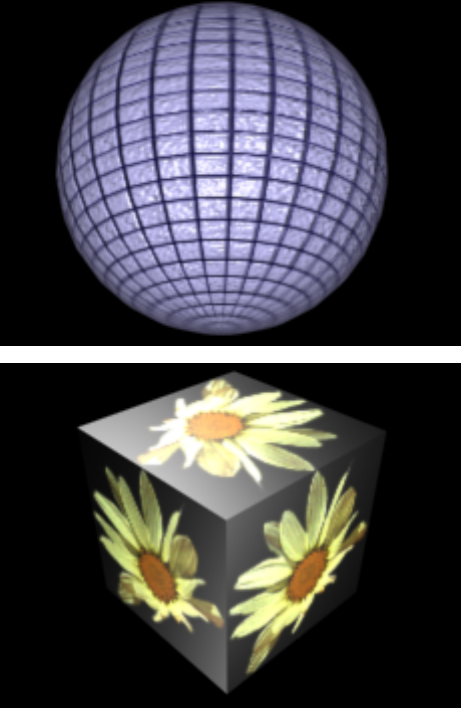
Select an object. > Modifiers menu > UVW Map
Mapping a sphere and a box.
By applying mapping coordinates to an object, the UVW Map modifier controls
how mapped and procedural materials appear on the surface of an object.
Mapping coordinates specify how bitmaps are projected onto an object. The
UVW coordinate system is similar to the XYZ coordinate system. The U and
V axes of a bitmap correspond to the X and Y axes. The W axis, which
corresponds to the Z axis, is generally only used for procedural maps. A
bitmap's coordinate system can be switched in the Material Editor to VW or
WU, in which case the bitmap is rotated and projected so that it is
perpendicular to the surface.
1850 | Chapter 9 Modifiers

Primitive objects, like spheres and boxes, can generate their own mapping
coordinates, as can loft objects and NURBS surfaces. Scanned, imported, or
hand-constructed polygonal or patch models do not have mapping coordinates
until a UVW Map modifier is applied.
NOTE Drawings that are imported or linked from Autodesk Architectural Desktop
and Autodesk Revit do retain the mapping coordinates that were assigned to
objects by those products.
If you apply a UVW Map modifier to an object with built-in mapping
coordinates, the applied coordinates take precedence if map channel on page
7836 1 in the UVW Map modifier is used. The Generate Mapping Coordinates
option, available during the creation of primitives, uses map channel 1 by
default.
You use the UVW Map modifier to:
■Apply one of the seven types of mapping coordinates to an object on a
specified map channel. A diffuse map on map channel 1 and a bump map
on map channel 2 can have different mapping coordinates and can be
controlled separately by using two UVW Map modifiers in the modifier
stack
■Apply one of the seven types of mapping coordinates to an object.
■Transform the mapping gizmo to adjust map placement. Objects with
built-in mapping coordinates lack a gizmo.
■Apply mapping coordinates to an object with no mapping coordinates,
an imported mesh, for example.
■Apply mapping at the sub-object level.
Map Channels
You can control the type of mapping coordinates and the placement of the
mapping gizmo for each bitmap in a material that uses multiple bitmaps by
assigning explicit map channels to the bitmaps. In the Material Editor you
assign each map a different channel number, then you add multiple UVW
Map modifiers to the object's modifier stack, each UVW Map modifier is set
to a different map channel. To change the type of mapping or gizmo placement
for a particular bitmap, you select one of the UVW Map modifiers in the
modifier stack and change the parameters. You can change the name of a
UVW Map modifier in the Edit Modifier Stack dialog to correlate the modifier
to the bitmap.
UVW Map Modifier | 1851
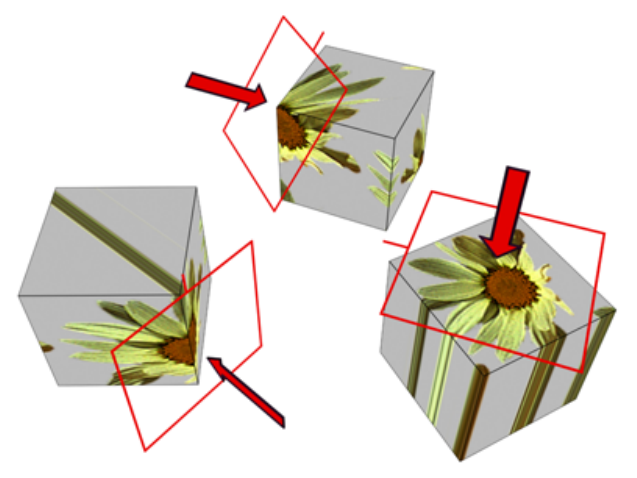
Transforming UVW Map Gizmos
Changing a map's location by moving the gizmo.
The UVW Map gizmo projects mapping coordinates onto an object. You can
position, rotate, or scale a gizmo to adjust map coordinates on an object; you
can also animate the gizmo. Gizmo transformations remain in effect if you
select a new map type. For example, if you scale a spherical mapping gizmo
and then switch to planar mapping, then the planar mapping gizmo is also
scaled.
Gizmo Display for Different Map Types
For planar, spherical, cylindrical and shrink wrap maps, a short yellow line
indicates the top of the map. The green edge of the gizmo indicates the right
side of the map. On a spherical or cylindrical map the green edge is the seam
where the left and right edge meet. Gizmo must be selected in the modifier
display hierarchy to display the gizmo.
1852 | Chapter 9 Modifiers
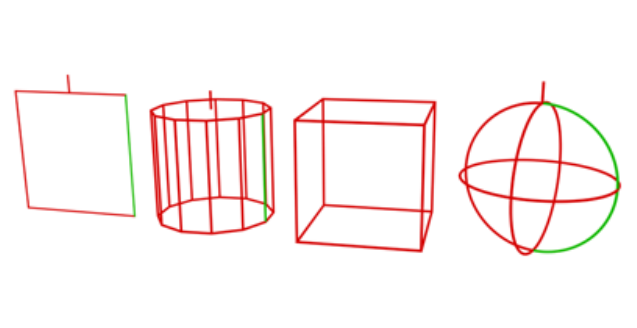
Gizmos for different projection types
Left to right: planar, cylindrical, box, and spherical
Effects of Transforming the UVW Map Gizmo
Moving the gizmo changes the center of projection and affects all types of
mapping. Rotating the gizmo changes the orientation of the map, which
affects all types of mapping. Uniform scaling does not affect spherical or
shrink-wrap mapping. Non-uniform scaling affects all types of mapping.
If you scale a gizmo smaller than the geometry, then a tiling effect is created,
unless scaling has no effect on the map type in use. Tiling based on gizmo
size is in addition to tiling values set in the Material Editor Coordinates rollout
for the map or the UVW Map modifier tile controls.
UVW Map Modifier | 1853
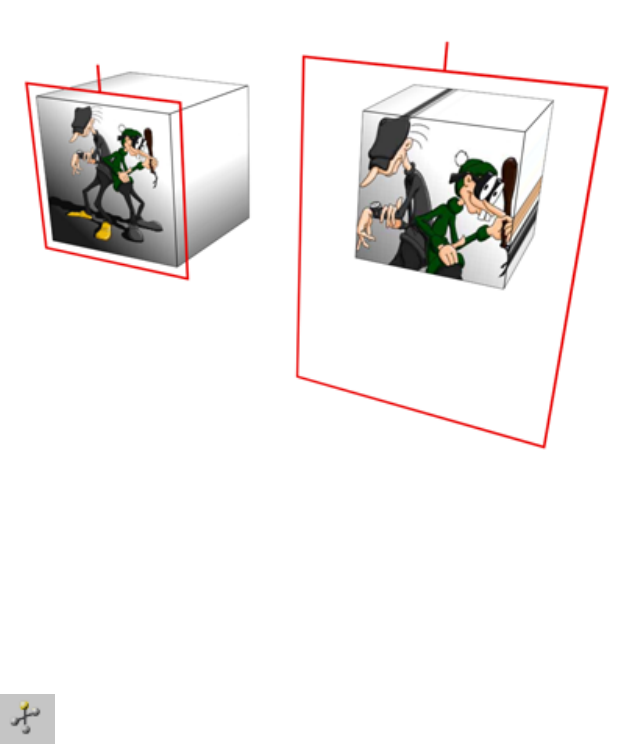
The size of the gizmo affects how the mapping is applied to an object.
Manipulators for UVW Map
The UVW Map modifier has graphic manipulators to help you adjust the
mapping dimensions and tiling when Real-World Map Size is off. When
Real-World Map Size is on, you can adjust positioning only for the Planar and
Box mapping types.
Manipulators are visible and usable while the Select And Manipulate
button on page 2529 is active. This button is on the default toolbar on page
7283 . When you move the mouse over a manipulator, the manipulator turns
red to show that dragging or clicking it will have an effect. Also, a tooltip
appears, showing the object name, the parameter, and its value.
For more information on using the UVW Map manipulators, see the
Procedures section on page 1856 .
UV width/length manipulators In a viewport, drag the edges of the UVW
Map gizmo to change the width or height.
1854 | Chapter 9 Modifiers
UV tiling manipulators In a viewport, drag the small circle next to the U
edge or V edge to adjust the tiling in that dimension.
Tile Controls
Use the UVW Tile controls if you want a map to repeat. Tiled maps are useful
for bricks on a wall, or tiles on a floor. Rather than creating one large map,
seamless maps can be tiled to surface a large area without visible seams, to
give the illusion of a large map.
Tiling in the UVW Map modifier affects only the objects that use this modifier.
Tiling a map in the Material Editor affects tiling on all the objects that use the
material.
Material and UVW Map tiling are multiplied. For example, if a map in the
Material Editor has a tile value of 2 on one axis, and a UVW Map modifier
has a tiling value of 3 on the same axis, then the result is a tiling value of 6.
Objects with No Mapping Coordinates
If you render an object that doesn't have mapping coordinates or a UVW Map
modifier, and the object uses a material with 2D bitmaps or 3D procedural
maps that use explicit map channels, then a Missing Map Coordinates on
page 5618 alert is displayed. The alert lists both the name of the object and the
UVW channels or Vertex Color channels that are missing the coordinates. For
example: (UVW 2): Torus01.
Mapping Selection Sets or Grouped Objects
You can apply one UVW Map modifier to a selection of objects. One large
mapping gizmo will encompass the entire selection unless the Use Pivot Points
option is turned on in the modifiers rollout before applying the UVW Map
modifier. If the Use Pivot Points option is used then each object is encompassed
with its own mapping gizmo.
If any of the objects in the selection has had its pivot point shifted in the
Hierarchy > Pivot panel, and you use the Use Pivot Points option with the
UVW Map modifier, then the mapping gizmos are centered to the pivot points
rather than the object center and the mapping may be tricky to position the
way you want.
Real-World Mapping
The idea behind real-world mapping is to simplify the use of texture mapped
materials which are scaled correctly with the geometry in the scene. This
UVW Map Modifier | 1855
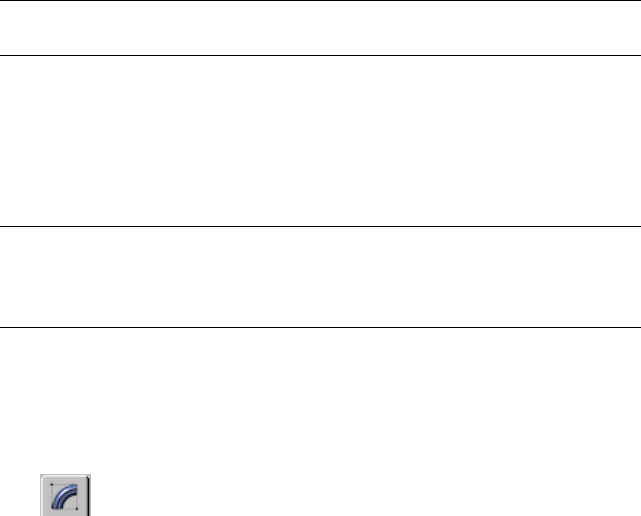
feature gives you the ability to create a material and specify the actual width
and height of a 2D texture map in the material editor. When you assign that
material to an object in the scene, the texture map appears in the scene with
the correct scaling.
There are two parts to the equation in order for real-world mapping to work.
First, the correct style of UV texture coordinates must be assigned to the
geometry. Basically, the size of the UV space needs to correspond to the size
of the geometry. Therefore, a new switch, called Real-World Map Size, has been
added to many of the dialogs and rollouts where you can generate texture
coordinates. Any dialog or rollout in which you have the option to turn on
Generate Mapping Coords, also has a switch where you can turn on Real-World
Map Size.
NOTE There are a few primitive objects that do not have a Real-World Map Size
switch. These are Torus Knot, Hedra, Prism and RingWave.
The other part of the equation is in the material editor. When you create a
material and use a 2D texture map, you now see a new switch in the
Coordinates rollout called Use Real-World Scale. When this switch is turned on,
the default, the Width and Height spinners are enabled that let you specify
the horizontal/vertical offsets and size of the texture map in current display
units on page 7601 .
NOTE Autodesk VIZ scenes with objects using real-world mapping coordinates
will display differently when opened in 3ds Max. This is because real-world mapping
coordinates is not the default method of generating mapping coordinates in 3ds
Max.
Procedures
To apply the UVW Map modifier:
1Assign a mapped material to an object.
2 On the Modify panel, choose UVW Map from the Modifier List.
3Adjust the mapping parameters.
By default, the UVW Map modifier uses planar mapping on map channel
1. You can change the type of mapping and the map channel to suit your
needs. There are seven types of mapping coordinates, ninety-nine map
channels, tiling controls, and controls to size and orient the mapping
gizmo in the UVW Map modifier.
1856 | Chapter 9 Modifiers
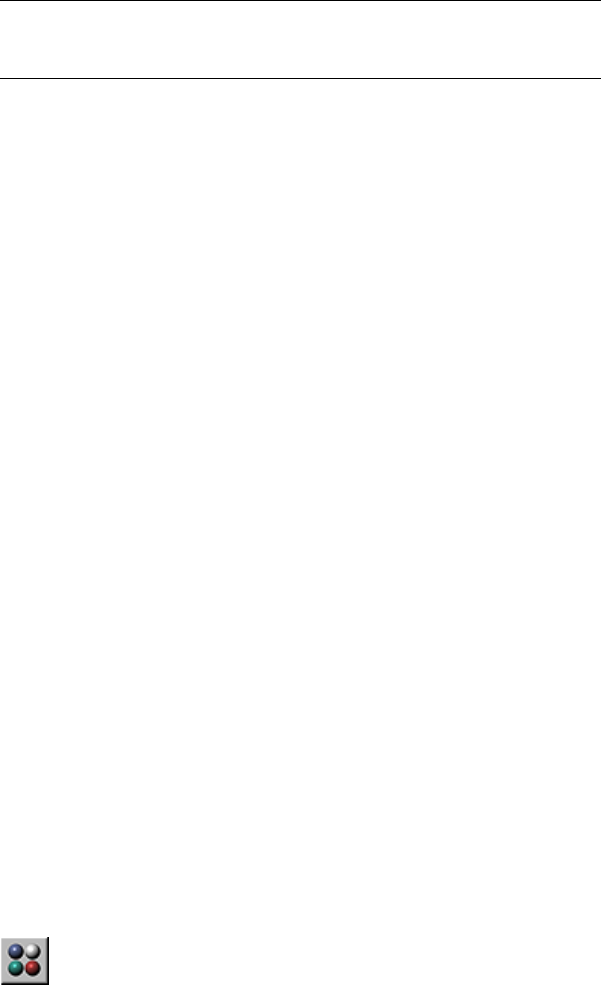
NOTE If a UVW Map modifier is applied to multiple objects, the UVW Map
gizmo is defined by the selection, and the mapping that results is applied to
all the objects.
To use multiple UVW channels in the same object:
1Assign Map channel 1 to an object. You can do this by either turning on
Generate Mapping Coordinates in the Parameters rollout of any primitive,
or by assigning a UVW Map modifier with channel 1 chosen.
Generate Mapping Coordinates uses map channel 1 by default.
2Assign a UVW Map modifier (or a second one, if you're using the first to
assign channel 1). Choose channel 2 for this modifier.
Both coordinate channels are now assigned to the geometry. The next
step is to assign a mapped material that uses both channels.
3Create a material with two maps. You can do this using a Composite
map, or a Blend material with two maps, or you can have one map
assigned to Diffuse and another assigned to Bump. Perhaps the easiest
way to see the effect is to composite two maps, with the second map
containing an alpha channel.
4Go to the level of one of the maps and, in the Mapping list, choose
Explicit Map Channel 2.
The other map is already assigned channel 1 by default.
5Assign the mapped material to the object.
You can switch between viewing the maps in the viewport using the
Show Map In Viewport control in the Material Editor. You can adjust the
mapping of channel 2 without altering the mapping of channel 1 if you've
assigned two UVW Map modifiers. Render the scene to see the effect.
To use the XYZ to UVW option:
The XYZ to UVW option is used to make a 3D procedural texture, like Cellular,
follow the animated surface of an object. If the object stretches, so does the
3D procedural texture. Currently, it cannot be used with NURBS objects and
is unavailable if a NURBS object is selected.
1In the Top viewport, create a box.
2 Create a material with a Cellular diffuse map.
UVW Map Modifier | 1857

3In the Material Editor, on the Coordinates rollout of the Cellular map,
open the Source drop-down list, and choose Explicit Map Channel.
On the Coordinates rollout, the Map Channel parameter activates, leave
the value at 1.
4Assign the material to the box.
5 On the Modify panel, choose UVW Map from the Modifier List.
6On the UVW Map modifier, turn on XYZ to UVW.
By default, the Map Channel value is 1.
7Render the Front viewport.
The cellular pattern renders normally on the surface of the box.
8Right-click over the object and choose Convert To: > Convert to Editable
Mesh from the Transform (lower-right) quadrant of the quad menu.
The box is converted to an editable mesh.
9 On the Modify panel, click to turn on Vertex on the Selection
rollout.
10 In the Front viewport, select the top vertices of the box, and move them
up.
11 Render the Front viewport again.
The cellular pattern stretches with the box. This effect is enabled by the
XYZ to UVW option. To see the difference, we will change the Source
option in the Coordinates rollout in the Material Editor.
12 In the Material Editor, locate the diffuse Cellular material.
13 On the Coordinates rollout of the Cellular diffuse map, open the Source
drop-down list and choose Object XYZ.
14 Render the Front viewport.
The cellular pattern is no longer stretched.
1858 | Chapter 9 Modifiers

To transform the UVW Map gizmo:
1 On the Modify panel, choose the UVW Map modifier in the stack
display.
2In the stack display, choose the Gizmo sub-object level.
The gizmo changes to a yellow color, with one green edge.
The green edge indicates the right edge of the texture.
3Move, scale, or rotate the gizmo in the viewports, or use the Length and
Width controls in the UVW Map modifier.
Transforming the map gizmo shifts the bitmap, allowing you to orient
and move the map on the object's surface.
To use manipulators to control the width and length:
1 On the Modify panel, choose the UVW Map modifier in the stack
display.
You can also be at the Gizmo level of the modifier.
2 On the default main toolbar, click to turn on Select And
Manipulate.
The UVW Map modifier's gizmo turns green, showing it is now a
manipulator. Also, two small circles appear next to two of the gizmo's
edges.
3Drag an edge of the gizmo to adjust the width or length.
A tooltip shows the new width or length value.
To use manipulators to control tiling:
1 On the Modify panel, choose the UVW Map modifier in the stack
display.
You can also be at the Gizmo level of the modifier.
UVW Map Modifier | 1859

2 On the default main toolbar, click to turn on Select And
Manipulate.
The UVW Map modifier's gizmo turns green, showing it is now a
manipulator. Also, two small circles appear next to two of the gizmo's
edges.
3Drag one of the circles to adjust tiling in the U or V dimension.
A tooltip shows which dimension you are adjusting, and the new tiling
value in that dimension.
Interface
Modifier Stack
Gizmo sub-object level Enables gizmo transformations. At this sub-object
level you can move, scale, and rotate the gizmo in the viewports to position
the mapping. In the Material Editor, you turn on the Show Map in Viewport
option to make the map visible in a shaded viewport, the map moves on the
surface of the object as you transform the gizmo.
1860 | Chapter 9 Modifiers
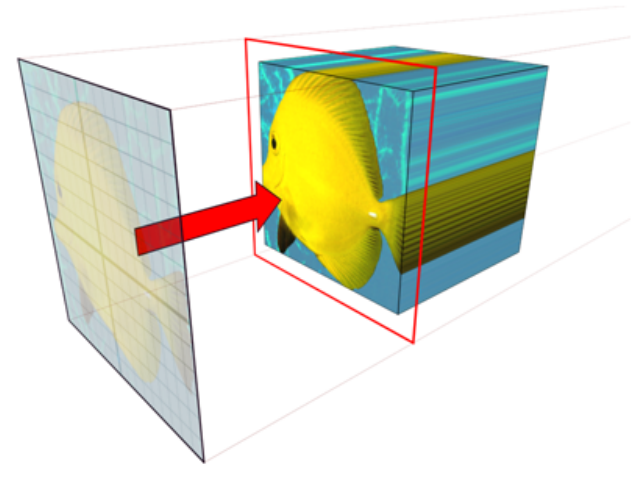
Mapping group
Determines the type of mapping coordinates used. Different kinds of mapping
are distinguished by how the map is geometrically projected onto the object
and how the projection interacts with the object's surfaces.
Planar Projects the map from a single plane flat against the object, somewhat
like projecting a slide.
Planar projection is useful when only one side of an object needs to be mapped.
It is also useful for obliquely mapping multiple sides, and for mapping two
sides of a symmetrical object.
Planar map projection
Cylindrical Projects the map from a cylinder, wrapping it around an object.
Seams where the edges of the bitmap meet are visible unless a seamless map
is used. Cylindrical projection is useful for objects that are roughly cylindrical
in shape.
UVW Map Modifier | 1861
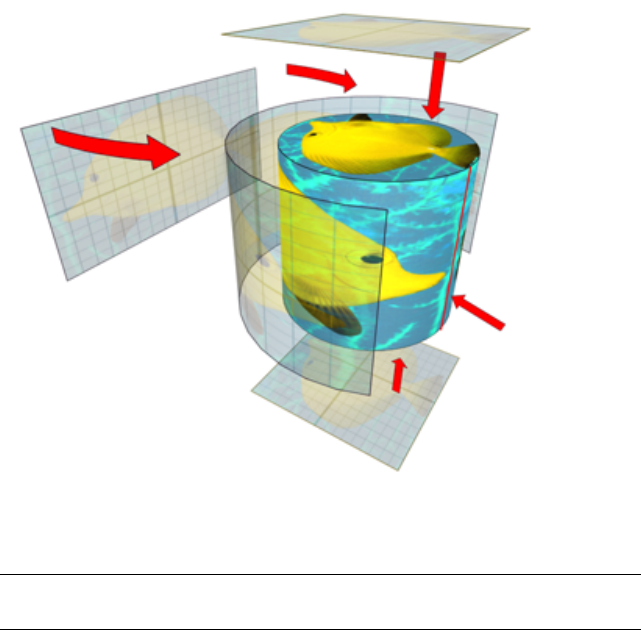
Cylindrical map projection
Cap Applies planar mapping coordinates to the caps of the cylinder.
NOTE If the ends of the object geometry are not at right angles to the sides, the
Cap projection bleeds onto the sides of the object.
Spherical Surrounds the object by projecting the map from a sphere. You
see a seam and mapping singularities at the top and bottom of the sphere
where the bitmap edges meet at the sphere's poles. Spherical mapping is useful
for objects that are roughly spherical in shape.
1862 | Chapter 9 Modifiers
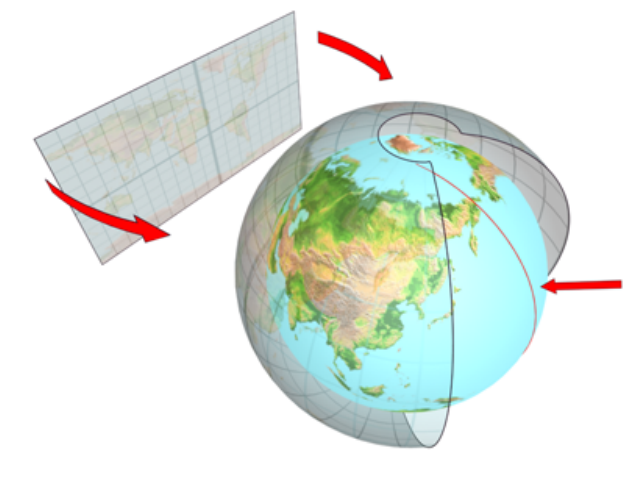
Spherical map projection
Shrink Wrap Uses spherical mapping, but truncates the corners of the map
and joins them all at a single pole, creating only one singularity. Shrink-wrap
mapping is useful when you want to hide the mapping singularity.
UVW Map Modifier | 1863
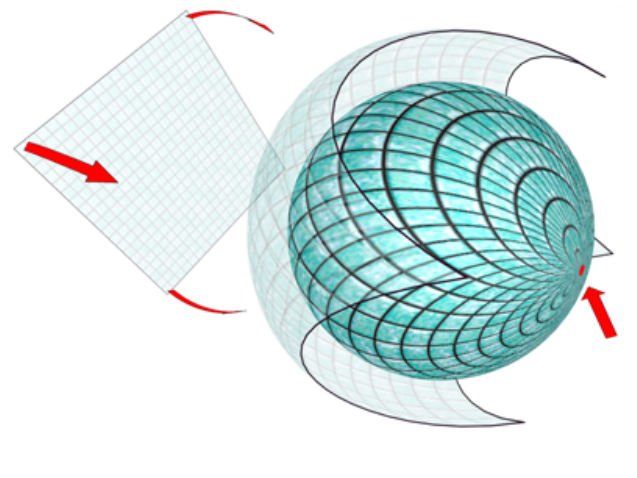
Shrink-wrap projection
Box Projects the map from the six sides of a box. Each side projects as a
planar map, and the effect on the surface depends on the surface normal. Each
face is mapped from the closest box surface whose normal most closely parallels
its own normal.
1864 | Chapter 9 Modifiers
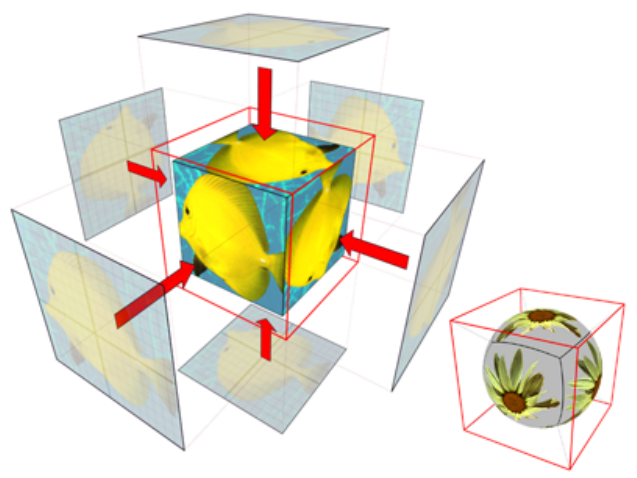
Box projection (shown on a box and on a sphere)
Face Applies a copy of the map to every face of an object. Pairs of faces
sharing a hidden edge are mapped with the full rectangular map. Single faces
with no hidden edge are mapped with a triangular portion of the map.
UVW Map Modifier | 1865
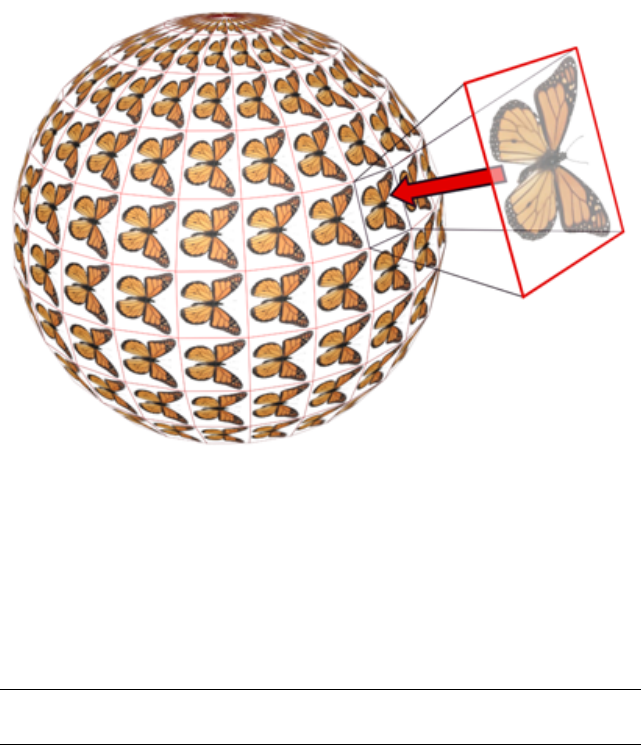
Face projection
XYZ to UVW Maps 3D procedural coordinates to UVW coordinates. This
"sticks" the procedural texture to the surface. If the surface stretches, so does
the 3D procedural map. Use this option with procedural textures, like Cellular
on page 5700 , on objects with animated topologies. Currently, XYZ to UVW
cannot be used with NURBS objects and is disabled if a NURBS object is
selected.
NOTE In the Material Editor's Coordinates rollout for the map, set Source to Explicit
Map Channel. Use the same map channel in the material and UVW Map modifier.
1866 | Chapter 9 Modifiers
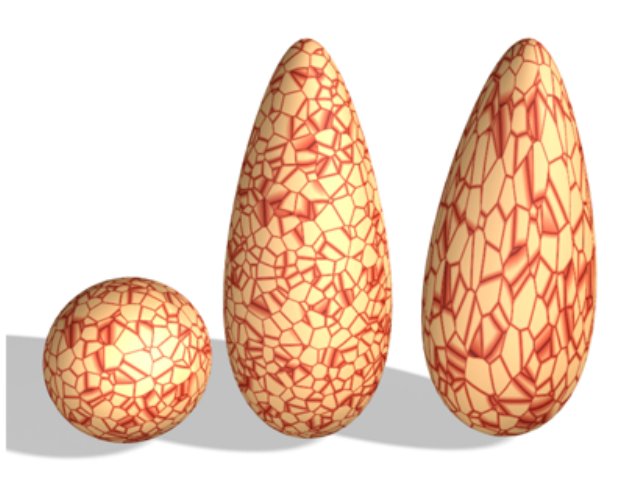
A sphere with a 3D procedural texture is copied, and the copies are stretched.
Right: Using XYZ to UVW on the object enables the 3D procedural texture to stick and
stretch with the surface.
Length, Width, Height Specify the dimensions of the UVW Map gizmo. The
default scale of the mapping icon is defined by the largest dimension of the
object when you apply the modifier. You can animate the projection at the
gizmo level. Note the following facts about these spinners:
■The dimensions are based on a bounding box of the gizmo.
The Height dimension is unavailable for the Planar gizmo: It does not have
depth. Likewise, the dimensions for Cylindrical, Spherical, and Shrink
Wrap mapping all display the dimensions of their bounding box and not
their radiuses. No dimensions are available for the Face map: Each face on
the geometry contains the entire map.
■The three dimensions are set to 1 or 2, depending on map type and
dimensions, when you load files created in Autodesk VIZ or earlier versions
of 3ds Max. (This maintains compatibility with files from previous releases,
in which gizmos were scaled non-uniformly to adjust their dimensions.).
The dimensions essentially become scale factors rather than measurements.
You can reset the values to dimensions by clicking the Fit or Reset buttons,
which will lose the original non-uniform scaling.
UVW Map Modifier | 1867
U Tile, V Tile, W Tile Let you specify the dimensions of the UVW map, for
tiling the image. These are floating-point values, which you can animate to
displace the map's tiling over time.
Flip Reverses the image about the given axis.
Real-World Map Size Controls the scaling method used for texture mapped
materials that are applied to the object. The scaling values are controlled by
the Use Real-World Scale settings found on the applied material's Coordinates
rollout on page 5620 . Default=on.
When on, the Length, Width, Height and Tiling spinners are unavailable.
Channel group
Each object can have up to 99 UVW mapping coordinate channels. The default
mapping (from the Generate Mapping Coordinates toggle) is always channel
1. The UVW Map modifier can send coordinates to any channel. This lets you
have many different sets of coordinates on the same face simultaneously.
Map Channel Sets the map channel. The UVW Map modifier defaults to
channel 1, so mapping behaves in the default fashion (and in the fashion of
earlier software releases) unless you explicitly change to another channel.
Default=1. Range=1 to 99
To use the additional channels, you must not only choose a channel in the
UVW Map modifier, but also assign an explicit map channel at the map level
of the material assigned to the object. You can use many UVW Map modifiers
in the modifier stack, each one controlling the mapping coordinates of
different maps in a material.
Vertex Color Channel Define the channel as a vertex color channel by
choosing this option. Be sure to match any material mapping in the
coordinates rollout to be Vertex Color as well, or by using the Assign Vertex
Colors utility on page 5849 .
The Map channels are accessed in various places in the software, as follows:
■Generate Mapping Coords This check box, in the creation parameters
of most objects, assigns Map channel 1 when turned on.
■UVW Map Modifier Contains options for channels 1 through 99. This
lets you specify which UVW coordinates are used by this UVW Map
modifier. The modifier stack can pass these channels simultaneously for
any face.
■UVW XForm and Unwrap UVWs These two modifiers also contain
Channel option buttons.
1868 | Chapter 9 Modifiers
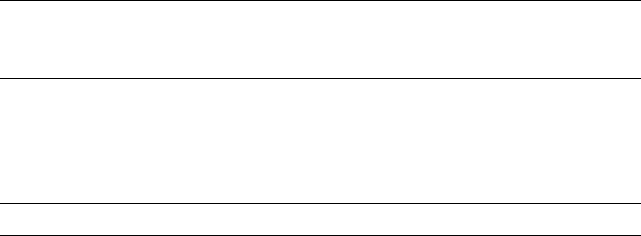
■Material Editor Channel Assignment You assign the channel to be used
by a map in the Coordinates rollout at the map level in the Material Editor.
■The assignment varies depending on the type of map:
2D Maps In the Mapping list for the Texture option, you can choose
Explicit Map channel, Vertex Color Channel, Planar from Object XYZ, or
Planar from World XYZ.
3D Maps At the top of the Coordinates rollout, there is a Source list where
you can choose an Explicit Map Channel, Vertex Color Channel, Object
XYZ, or World XYZ. Use the Map Channel spinner to define the channel
number.
■NURBS Surface Objects and Sub-Objects Let you specify which Map
channel the surface uses.
Alignment group
X/Y/Z Select one of these to flip the alignment of the mapping gizmo. Each
specifies which axis of the gizmo is aligned with the local Z axis of the object.
NOTE These options aren't the same as the Flip check boxes beside the U/V/W
Tile spinners. The Alignment option buttons actually flip the gizmo orientation,
while the Flip check boxes flip an assigned map's orientation.
Manipulate When on, a gizmo appears on the object that lets you change
parameters in the viewport. When Real-World Map Size is on, Manipulate is
available only with the Planar and Box mapping types. For more information,
see Manipulators for UVW Map on page 1854 .
TIP Turn on snapping to adjust the mapping precisely.
Fit Fits the gizmo to the extents of the object and centers it so that it's locked
to the object's extents. Unavailable when Real-World Map Size is on.
Center Moves the gizmo so that its center coincides with the center of the
object.
Bitmap Fit Displays the standard bitmap file browser so that you can pick
an image. Unavailable when Real-World Map Size is on.
For planar mappings, the map icon is set to the aspect ratio of the image. For
cylindrical mapping, the height (rather than the radius of the gizmo) is scaled
to match the bitmap. For best results, first use the Fit button to match the
radius of the object and gizmo, and then use Bitmap Fit.
UVW Map Modifier | 1869
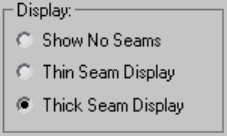
Normal Align Click and drag on the surface of the object to which the
modifier is applied. The origin of the gizmo is placed at the point on the
surface where the mouse is pointing; the XY plane of the gizmo is aligned to
the face. The X axis of the gizmo lies in the object's XY plane.
Normal Align respects smoothing groups and uses the interpolated normal
based on face smoothing. As a result, you can orient the mapping icon to any
part of the surface, rather than having it "snap" to face normals.
View Align Reorients the mapping gizmo to face the active viewport. The
size of the icon is unchanged.
Region Fit Activates a mode in which you can drag in the viewports to define
the region of the mapping gizmo. The orientation of the gizmo is not affected.
Unavailable when Real-World Map Size is on.
Reset Deletes the current controller controlling the gizmo and plugs in a
new one initialized using the Fit function. Any animation to the gizmo is lost.
As with all the alignment options, you can cancel the reset operation by
clicking Undo.
Acquire Effectively copies the UVW coordinates from other objects When
you pick an object from which you want to acquire UVWs, a dialog prompts
you whether the acquire should be done in an absolute or relative fashion.
If you choose Absolute, the acquired mapping gizmo is positioned exactly on
top of the mapping gizmo you pick. If you choose Relative, the acquired
mapping gizmo is positioned over the selected object.
Display group
This setting determines whether and how mapping discontinuities, also known
as seams, appear in the viewports. The seams appear only when the Gizmo
sub-object level is active. The default seam color is green; to change it, go to
Customize menu > Customize User Interface > Colors tab, and then from the
Elements drop-down list, choose UVW Map.
1870 | Chapter 9 Modifiers
The options are:
■Show No Seams Mapping boundaries don't appear in the viewports. This
is the default choice.
■Thin Seam Display Displays mapping boundaries on object surfaces in
the viewports with relatively thin lines. The line thickness remains constant
as you zoom the view in and out.
■Thick Seam Display Displays mapping boundaries on object surfaces in
the viewports with relatively thick lines. The line thickness increases when
you zoom the view in and decreases when you zoom out.
UVW Mapping Add Modifier
Select an object. > Modify panel > Modifier List > UVW Mapping Add
Select an object. > Channel Info on page 5858 > Add a channel.
The UVW Mapping Add modifier is added to an object's modifier stack when
you add a channel in the Channel Info utility on page 5858 . You can also add
the modifier explicitly by choosing it from the Modifier List. It has no user
interface.
To merge the results of the add operation into the object's geometry, collapse
the modifier stack after adding.
UVW Mapping Clear Modifier
Select an object. > Modify panel > Modifier List > UVW Mapping Clear
Select an object. > Channel Info on page 5858 > Clear a channel.
The UVW Mapping Clear modifier is added to an object's modifier stack when
you clear a channel with the Channel Info utility on page 5858 . You can also
add the modifier explicitly by choosing it from the Modifier List.
To merge the results of the deletion into the object's geometry, collapse the
modifier stack after deleting.
UVW Mapping Add Modifier | 1871
Interface
Map Channel Specifies the map channel to clear. This is equivalent to clearing
a specific channel in the Channel Info utility. If the specified map channel
doesn't exist, the modifier has no effect.
UVW Mapping Paste Modifier
Select an object. > Channel Info on page 5858 > Copy and then paste a channel.
The UVW Mapping Paste modifier is added to an object's modifier stack when
you paste a channel in the Channel Info utility on page 5858 . It isn't available
from the modifier list, and has no user interface.
To merge the results of the paste operation (for example, a vertex selection)
into the object's geometry, collapse the modifier stack after pasting.
UVW XForm Modifier
Modify panel > Make a selection. > Modifier List > Object-Space Modifiers >
UVW XForm
Select an object. > Modifiers menu > UV Coordinates > UVW XForm
Use the UVW XForm modifier to adjust tiling and offset in existing UVW
coordinates on page 7962 . If you have an object with complex UVW coordinates
already applied (such as a Loft object, or a parametric object with generated
coordinates), you can apply this modifier to adjust those coordinates further.
For example, if you create a torus and turn on Generate Mapping Coordinates,
the UVW coordinates work perfectly with the torus, but if you want to tile or
move the coordinates, you would previously have needed to do it at the
material/map level. Now you can apply a UVW XForm modifier to alter the
built-in coordinates. You can use a Mesh Select or Edit Mesh modifier to apply
a UVW Adjust to sub-object selections, as well. This is handy if you want to
rotate the mapping on a particular portion of an object.
1872 | Chapter 9 Modifiers
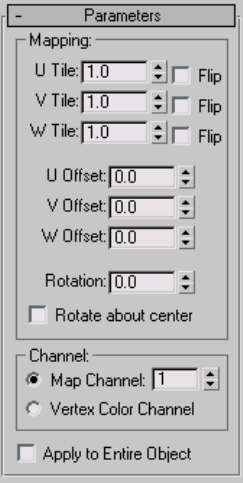
Interface
Mapping group
U Tile, V Tile, W Tile Alter the tiling along any of the three coordinate axes.
Flip Reverses the direction of the map along the specified axis.
U Offset, V Offset, W Offset Move the map in the direction of the specified
axis coordinate.
Rotation Rotates the map.
Rotate About Center When active, the map rotates about the center of the
object. If this is applied to a sub-object selection, it uses the center of that
selection.
When this is turned off, the map rotates about the corner of the U and V
coordinate gizmo.
UVW XForm Modifier | 1873
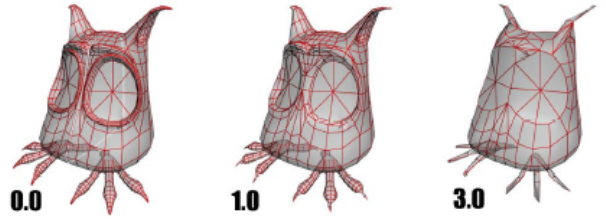
Channel group
Specifies whether to apply the transform to a mapping channel or a vertex
color channel, and which channel to use. For more information on these
channels, see UVW Map Modifier on page 1849 .
Map Channel Specifies a UVW channel to use for the mapping, and use the
spinner to its right to set the channel number.
Vertex Color Channel Uses the vertex color channel for the mapping.
Apply To Entire Object If the UVW Xform modifier is applied to an active
sub-object selection, such as face or patch, this switch controls whether the
settings of the UVW Xform modifier affect only the original sub-object
selection or affect the entire object.
Vertex Weld Modifier
Select a mesh, patch, or PolyMesh object. > Modify panel > Modifier List >
Vertex Weld
Select a mesh, patch, or PolyMesh object. > Modifiers menu > Mesh Editing
> Vertex Weld
The Vertex Weld modifier behaves like the Weld feature in Editable Mesh or
Editable Patch and welds all vertices that fall within the threshold setting.
Vertex Weld is very useful for cleaning up meshes that have vertices that are
close or overlapping, but not welded.
The results of three Vertex Weld threshold settings
1874 | Chapter 9 Modifiers
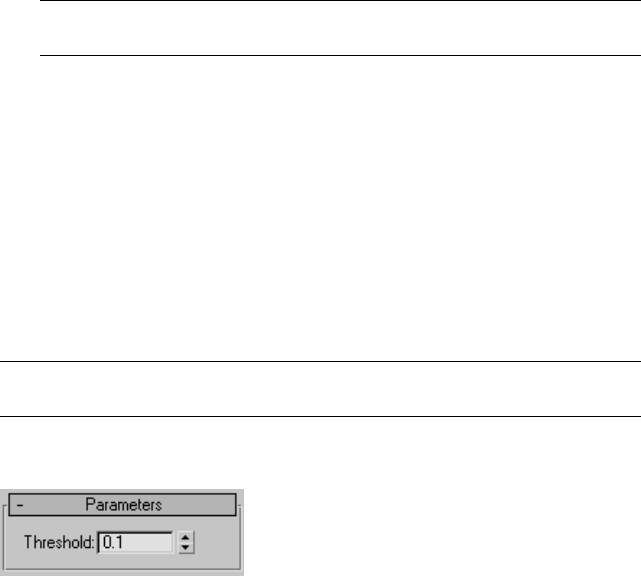
Procedures
Example: To apply the Vertex Weld modifier to a mesh:
1Create a box with Length, Width, and Height set to 40.
2Right-click the box and choose Convert to > Convert to Editable Poly.
3Set the sub-object mode to polygon, and select Polygon 6.
TIP Watch the listing at the bottom of the Selection rollout to see which
polygon is selected.
4Delete polygon 6.
By deleting the polygon, you create an open mesh.
5Apply a Turn To Poly modifier, and set the Selection Level to Object.
6Apply a Mirror modifier, and set Mirror Axis to X.
7Turn on Copy, and set Offset to –40.
The reflection of the box shares a common seam but the vertices along
the seam are not welded.
8Apply a Vertex Weld modifier to cement the two boxes into one element.
NOTE This combination of steps can be streamlined by using the Symmetry
modifier on page 1735 , which will mirror the mesh and weld it in a single operation.
Interface
Threshold The value of the Threshold setting delegates how close vertices
can be before they are automatically welded together. Default=0.1
Vertex Weld Modifier | 1875
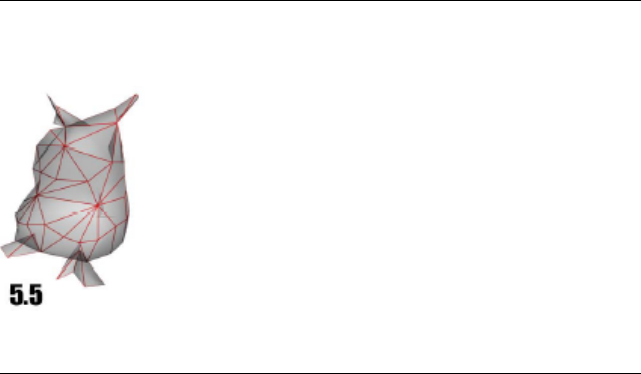
NOTE A higher threshold setting will result in welding more vertices, thus removing
smaller faces and details. If the threshold is set too high, the mesh will begin to
deform.
A threshold setting of 5.5 removes all detail, making the model unrecognizable.
VertexPaint Modifier
Select an object. > Modify panel > Modifier List > VertexPaint
Select an object. > Modifiers menu > Mesh Editing > Vertex Paint
Select an object. > Utilities panel > More > Assign Vertex Colors > Click Assign
To Selected. > Modify panel
The VertexPaint modifier lets you paint vertex colors onto an object. You're
not restricted to only vertex-level painting. Using sub-object selection, you
can also control which vertices get painted, face-by-face. All faces sharing a
vertex have the adjacent corner shaded as well. The resulting painted object
receives a coarse gradient across each face.
The amount of color that 3ds Max applies to a vertex depends on the distance
of the vertex from the position of the paint cursor on the face. The more you
select a face, the more it changes to the new color. The Opacity button also
controls the strength of the color. 3ds Max shades the color, so if you have
one green vertex and two white vertices for one face, for example, you'll see
a gradient on that face.
VertexPaint modifier also lets you paint values for the vertex alpha and
illumination channels. These channels affect the transparency and shading
of vertex colors, respectively.
1876 | Chapter 9 Modifiers
Notes and Tips
For best results with VertexPaint, keep the following in mind:
■VertexPaint is automatically applied to the selected object when you click
Assign Vertex Colors on page 5849 > Assign To Selected. It is not available
directly from the Modify panel or Modifiers menu.
■To render vertex colors, assign a Vertex Color map on page 5770 , as described
in To render vertex colors on page ? .
■If you select faces using the selection tools of the VertexPaint modifier,
you restrict your painting to the selected faces, as opposed to all faces. This
allows you to sharply define the edges of your painted selection.
■You can streamline the painting process by using the Brush Presets tools
on page 7293 .
■Each VertexPaint modifier works internally to itself, and cannot modify
existing vertex coloring. To paint over existing coloring, use the Condense
to single layer on page 1899 function.
About Map Channels and Vertex Color,Vertex Alpha, and Vertex
Illum
When using vertex paint, it is helpful to understand how 3ds Max manages
vertex color, alpha, illumination, and map channels. The software stores and
manages all of these different pieces of information using the same underlying
system.
The map channels are defined as triple-value channels (tuples) with a unique
integer ID number ranging from -2 to 99. The first five map channels have
specific and familiar usages:
■Channel (2): UVW “second pass” texture mapping coordinates
■Channel (1): UVW standard texture mapping coordinates
■Channel (0): RGB vertex color
■Channel (-1): FLOAT vertex alpha (really only 1 value needed)
■Channel (-2): RGB vertex illumination
Every geometric vertex of a mesh or poly object can be assigned up to 102
channel values (99 + 3).
VertexPaint Modifier | 1877
The reason for the negative numbering scheme for the vertex alpha and
illumination channels is actually historic: It serves to preserve the meaning
of existing map-channel data in older scene files before vertex alpha and
illumination were added.
You can paint on any arbitrary channel, and to use one or more channels for
any arbitrary meaning for a given vertex. It is useful in development of content
for games to paint on arbitrary map channels numbered higher than those
used for texture mapping (such as channels 3, 4, 5). These can be used to store
logical information about a vertex: for example, whether it is “slippery” or
“explosive.”
You can assign a single vertex a stack of map channels that carry different
meanings. When you collapse the modifier stack, the software preserves these
map channels.
The VertexPaint modifier takes this into consideration through its simple
exposure of map channel IDs for display and painting.
About Painting in Layers
The layer system allows you to paint changes on a single layer, then make
another layer on top of that, and paint additional changes. This can be used
to store different versions or variations of your vertex color painting.
Every layer has a blending mode that it uses to determine how it combines
with the other layers. You can assign vertex colors using the Assign Vertex
Colors utility on page 5849 , then add another layer, change the layer mode
operator to Lighten, and paint with a white paintbrush to lighten up areas.
Fifteen different modes are available, and many tasks can be accomplished
using paint layers.
One of the primary advantages of VertexPaint is its use of the modifier stack
as a kind of image-composite stack. Each VertexPaint modifier serves as a
single layer in the composite. You can move layers up and down the stack,
enable and disable them, and flatten the stack using Condense to single layer
on page 1899 .
Backward Compatibility
If you load an older file that uses a previous version of the VertexPaint
modifier, then the legacy modifier will be loaded when the file is opened.
The legacy modifier has not been changed, and the two modifiers are not
inherently compatible in terms of their data format during loading and saving.
1878 | Chapter 9 Modifiers
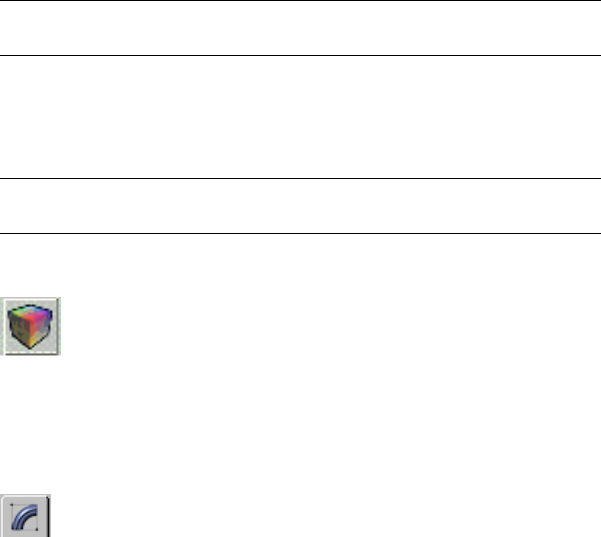
If you have vertex color data in a legacy VertexPaint modifier, you can use
the Condense to single layer tool on page 1899 of the new modifier to migrate
the vertex colors into the new modifier.
Procedures
To add scene lighting into an object's vertex color:
1Select the objects in the scene that you want to color.
2On the Modify panel, choose VertexPaint from the modifier list.
The floating Paintbox on page 1886 appears, docked to the left edge of
the viewports.
3Open the Assign Vertex Colors rollout.
NOTE This rollout provides the same tools as found in the Assign Vertex
Colors utility.
4In the Light Model group, turn on Lighting.
5In the Shadows group, turn on Calculate Shadows, if you want shadows
added.
TIP Turn on Shaded and choose Use Maps if you want to mix the texture
map information with the lighting and shades.
6Click Assign To Selected
7 On the Vertex Paintbox, turn on Vertex Color Display Shaded to
see the vertex lighting in the vertex color map.
To paint vertex colors on an object:
1Select the scene objects to paint.
2 On the Modify panel, choose VertexPaint from the Modifier List.
The Vertex Paintbox appears.
3Choose the color you want to paint with by clicking the large color swatch
below the Paintbrush button. This opens the Color Selector.
VertexPaint Modifier | 1879
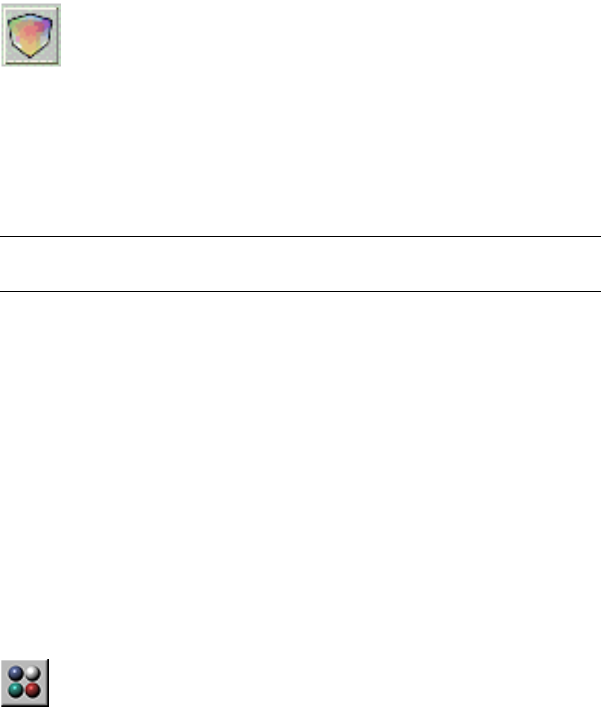
4Change the color using controls on the Color Selector.
5Adjust the strength of the color by entering a percentage value in the
Opacity field.
6 Click Vertex Color Display Unshaded to see the vertex colors
without shading.
7Click the Paint button and move the cursor over the selected object in
the viewport.
8When the cursor displays over the object, press and hold down the left
mouse button and drag to paint the object.
TIP The cursor displays the size of the brush. Use the Size spinner to change
to a larger or smaller brush.
To see vertex colors in a viewport:
1Right-click the object with painted vertices, and choose Properties from
the quad menu.
2In the Display Properties group, turn on the toggle for Vertex Color .
Vertex Color is one item on a drop-down list. The other items are Vertex
Illumination, Vertex Alpha, Map Channel Color (which uses the spinner
immediately below the list), and Soft Selection Color. Viewports can
display only one of these vertex channels at a time.
3Click OK.
To render vertex colors:
1 Open the Material Editor, and apply a Standard material to the
object.
2Click the map button for the Diffuse component.
3In the Material/Map Browser, choose Vertex Color as the map, and then
click OK.
Now, when you render the scene, the rendering shows the painted
vertices.
1880 | Chapter 9 Modifiers

To animate the opacity of a vertex color layer
1Choose the layer you wish to animate, by highlighting the Vertex Paint
modifier in the stack that corresponds to that layer.
2Turn on the Auto Key button.
3On the floating vertex paintbox, in the Layer group move the Opacity
slider.
This sets a key for the opacity.
4Move the time slider to another frame and again change the value using
the Opacity slider.
5Click Play to see the animated opacity in the viewport.
To animate vertex color using UVW XForm modifier:
You can use the UVW XForm modifier in conjunction with a specific vertex
paint layer to modulate vertex color effects in the viewport.
1Apply a UVW XForm modifier directly above the VertexPaint layer
(modifier) you want to modulate.
2Set the Channel type on the UVW XForm modifier to Vertex color.
3Animate the U, V, and W spinners using identical values. For example,
animate UVW from 1 to 0 over the length of the animation.
This will attenuate the RGB values of the underlying vertex color results
uniformly. It will effectively dim out the vertex color result directly below
the UVW XForm modifier.
NOTE Any additional vertex paint layers applied above the UVW XForm
modifier in the stack for the selected object(s) will be unaffected
TIP You can add multiple UVW XForm modifiers in your stack in this way,
giving some progressive control over modulated vertex colors. The effect is
always additive, however, and cannot be weight-blended.
To paint under an existing layer and view the result:
1Select an object that has several VertexPaint modifiers displayed in the
stack.
2In the modifier stack, activate the VertexPaint modifier that is the layer
you want to paint on.
VertexPaint Modifier | 1881

3 Turn on the Show End Result toggle.
Now, when you paint on the layer, you will see the painting taking place
under the top layer.
Interface
Parameter rollout
Selection group
The controls in this group are identical to the selection controls found in the
Selection group on page 1894 of the Paintbox rollout.
1882 | Chapter 9 Modifiers

Channel group
These controls specify which channel type the vertex paint layer will affect,
and which map channel number you'll paint on.
■Vertex Color Choose this to paint on a vertex color layer.
■Vertex Illum Choose this to paint on a vertex illumination layer.
■Vertex Alpha Choose this to paint on a vertex transparency layer.
■Map Channel Choose this to paint on a specifically named or numbered
map channel.
Map channel spinner Specifies the channel number. Available only when
Map Channel is chosen.
NOTE If you have painted on a layer and then change the channel setting, the
painted information will be moved to the new channel. For example if you select
Vertex Color and paint, then turn on Vertex Illum, the painted information will be
removed from the Vertex Color channel and applied to the Vertex Illum channel
instead.
Name If a channel has a name defined it will appear here. Channels can be
named using the Channel Info Utility on page 5858 .
Ignore underlying color When turned on, VertexPaint ignores whatever
vertex colors it receives from below it on the stack. As a result, you will see
the layer's raw colors on an otherwise white object. The blend mode has no
effect (it behaves like Normal mode) because the base color is considered
transparent, so the layer is not blended with anything.
The purpose of this toggle is to isolate a layer from the colors below, to help
the user visualize the layer's raw data. The layer is not completed isolated
when this is on, because layers above it can still affect the result. The user
needs to disable those layers or turn off Show End Result to see the current
layer in complete isolation.
The Ignore Base Color toggle should only be needed when the object at the
bottom of the stack already has some vertex colors baked in. In other cases,
you can just disable the paint layers or whichever modifiers are adding vertex
colors to the object. In that case, the active paint layer would not receive any
vertex colors from below itself on the stack. As a result, it treats all base color
as transparent and the layer colors are displayed in the raw (not blended with
anything).
VertexPaint Modifier | 1883

NOTE Per-vertex layer opacity is not passed up the stack. A paint layer modifier
makes a yes/no decision about whether an object below it has vertex colors or
not, and will subsequently treat all base colors as transparent or all as opaque. So
if you paint even a single vertex using Edit Mesh, for example, the object is
considered to have vertex colors, and a paint layer will blend its colors with the
(predominantly white) mesh instead of treating the mesh as transparent.
Preserve Layer When on, the modifier will not be deleted by any Condense
To Single Layer operation. Since Condense To Single Layer performs two
independent actions (creating a new baked-color modifier and then deleting
existing modifiers), this option allows access to only the first part of the
functionality when necessary. That is, you can bake colors into a new paint
layer, without being forced to have the old modifiers deleted.
Edit Displays the Vertex Paintbox floater on page 1886 if it has been closed.
1884 | Chapter 9 Modifiers

Assign Vertex Color rollout
This rollout gives you access to the same controls found in the Assign Vertex
Colors utility on page 5849 . They let you take the scene lighting information
and bake it into the vertex channel system.
VertexPaint Modifier | 1885
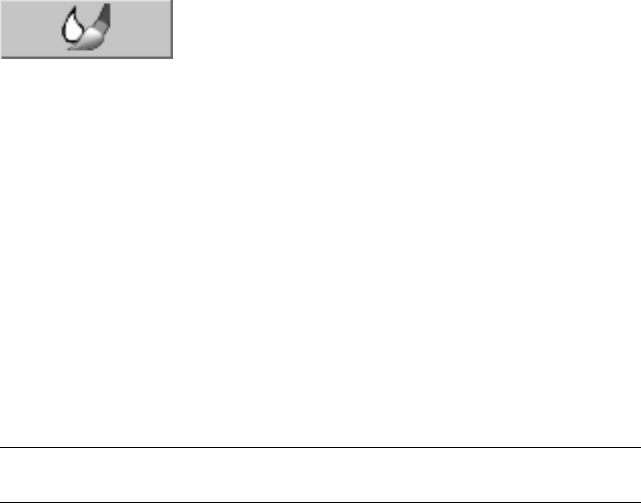
VertexPaint Paintbox
Select an object. > Modify panel > Modifier List > VertexPaint > Paintbox
dialog (Click Edit in the Parameters rollout if it isn't displayed.)
Select an object. > Modifiers menu > Mesh Editing > Vertex Paint > Paintbox
dialog (Click Edit in the Parameters rollout if it isn't displayed.)
Select an object. > Utilities panel > More > Assign Vertex Colors > Click Assign
To Selected > Modify panel > Modifier List > VertexPaint > Paintbox dialog
(Click Edit in the Parameters rollout if it isn't displayed.)
The VertexPaint modifier's Paintbox is a floating toolbox with various vertex
painting tools. The Paintbox is launched automatically after the VertexPaint
modifier on page 1876 has been applied to one or more objects. You can close
the Paintbox by clicking the X button in the upper-right corner of its window.
To open it again, click the Edit button in the Parameters rollout of the
VertexPaint Modifier
NOTE If a VertexPaint modifier is assigned to the object, you can also display the
Paintbox by clicking Edit in the Assign Vertex Color utility.
1886 | Chapter 9 Modifiers

Interface
VertexPaint Modifier | 1887
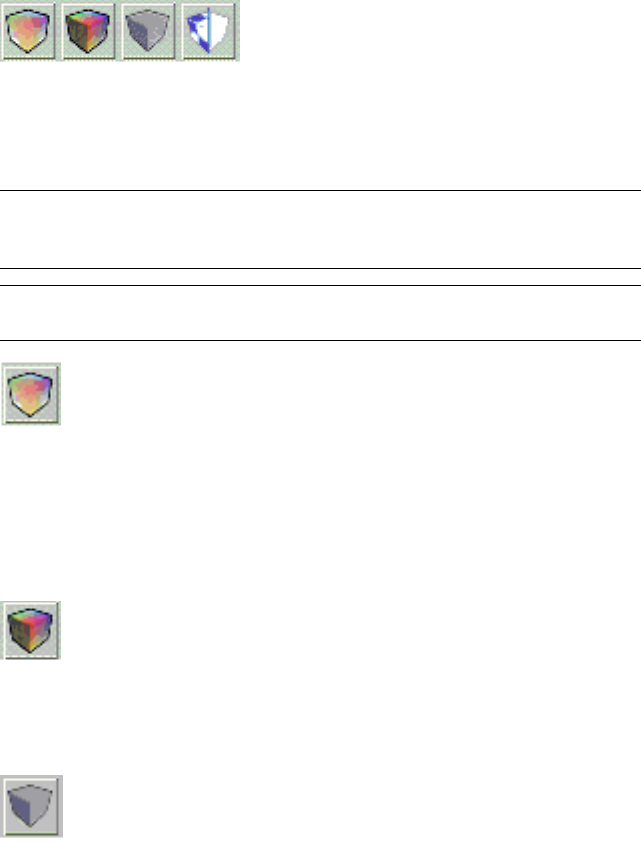
Vertex Color Display controls
Control the display of the vertex paint in the viewport by using the four icons
at the top of the floating panel. You can easily switch between shaded and
unshaded vertex color modes, or turn off the display of vertex color and or
texture maps.
NOTE The first three of these buttons stay highlighted when you click them, to
indicate which shading mode is active. Toggle Texture Display simply performs
the action without becoming highlighted.
NOTE These controls have no effect on wireframe viewports, but work for all
shaded viewports, including Lit Wireframe.
Vertex color display – unshaded Displays the currently selected
object in vertex color display mode. This mode is identical to the one offered
by the Object Properties menu (right click on object, select Properties > Turn
On Vertex Color in the Display Properties group, making sure that Shaded is
off.)
This has no effect on wireframe, but works on lit wireframe and all other
shaded display modes.
Vertex color display – shaded Displays the currently selected object
in vertex color display mode, with viewport lighting (shading). his mode is
identical to the one offered by the Object Properties menu (right click on
object, select Properties > Turn On Vertex Color in the Display Properties
group, making sure that Shaded is on.
Disable vertex color display Displays the currently selected object
in its current shading mode without showing vertex colors.
1888 | Chapter 9 Modifiers

Toggle texture display Displays or hides texture maps on the
currently selected object.
Viewport Channel Display selector
This menu allows you to select which one of the map channels to paint on:
■Vertex colors Choosing this lets you display the vertex color
channel in the viewport.
■Vertex alpha Choosing this lets you display and paint the vertex
transparency channel in the viewport.
■ Vertex Illum Choosing this lets you display and paint the vertex
lighting channel in the viewport.
■Map Channel Choosing this lets you define a numbered map
channel to paint on. Define the channel ID number with the Map Channel
Display spinner.
Map channel display in viewport flyout
What you see is what you paint, so whatever you select will both be displayed
and activated for painting.
VertexPaint Modifier | 1889
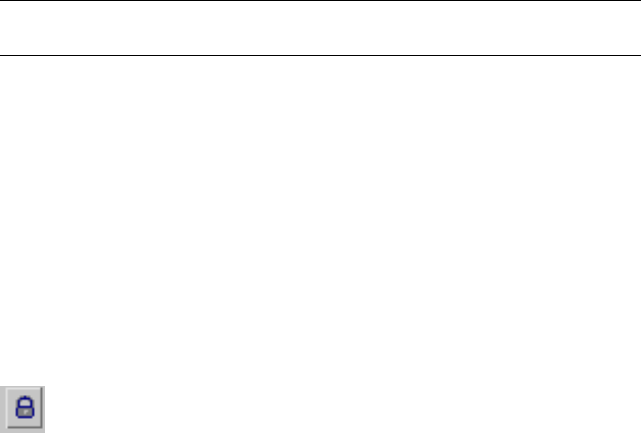
NOTE You cannot paint on all channels simultaneously as you could in the previous
version of the vertex paint modifier.
Map Channel Display Spinner This control lets you to numerically select a
channel other than the 3 conventional ones listed above, for display only. If
the channel you select is currently used for mapping coordinates, you'll see
red/yellow/green colors corresponding to the UVW values.
You might choose map channels above the standard channel 1, 2, 3 that do
typically get used for texture mapping. But you will need to keep track of your
own conventions, and/or use the Channel Info utility to track what has been
allocated for each object.
The Map Channel Display Spinner is only available when the Map Channel
display button. If you assign a new vertex paint modifier or create a new layer
and choose a particular numeric map channel, then select Map Channel
display, the spinner will become available.
Lock button The Lock button makes the Display Channel setting
unavailable, and automatically sets Display Channel to whatever channel you
choose on the Modify panel > Channel rollout. Keep this turned on, to ensure
that you're always displaying what you're painting.
If you want to glance at another channel without stopping your current paint
session, turn off the lock and then switch the display channel. When you are
finished, switch back and turn the lock back on.
1890 | Chapter 9 Modifiers

Vertex Paintbrush group
Vertex paint controls
Here are the controls that let you access the paintbrush and the paint. You
can choose color to paint with, from a color selector or from the scene. Choose
to adjust the brush size or envelope, or launch advanced paintbrush options
such as pressure sensitivity.
Paint All Performs a traditional paint fill operation on the current
object or sub-object selection. In the case of sub-object selections (vertices,
faces, elements) the fill will honor those selections. In the case of soft-selections
Paint all will do a “faded” fill, slowly tapering off the opacity based on the
soft selection settings.
As with the Paint button, this will either paint on the current layer, if one is
open in the Modify panel, or else it will create a new vertex paint layer
instanced across the selected objects.
Paint Starts the painting process. Once it is turned on,
you can start painting on the current selection, by moving the cursor into the
viewport and over the object.
VertexPaint Modifier | 1891

If there is a Vertex Paint modifier highlighted in the Modify panel, you will
be painting into that layer. But if the selected objects do not currently have
a vertex paint layer highlighted in the modify panel, then a dialog appears
letting you create a new modifier. This will be instanced across all the selected
objects.
You will not see the results of your brush strokes, unless the proper display
mode is set (above) Be sure your display mode and your paint target match.
For example – if you are painting on the alpha channel, be sure you are
displaying the alpha channel. If you are painting on the color channel, display
the color channel. Brush strokes will use the color specified in the color swatch
directly below the Paint button.
See Painter Options Dialog on page 1907 for more painting options.
Erase all Erases all painting applied to the currently selected objects
via the current VertexPaint modifier. This allows you to see through the
underlying color of the object’s vertices. This underlying color might come
from the object’s original vertex color, or from another vertex paint layer
directly below it in the modifier stack. This supports soft selection as well.
Erase Turns the brush into an eraser that will remove
paint from the currently selected objects. Erase mode will actually erase any
painting applied to the currently selected objects for the current layer of paint
(allowing the true color of the original objects vertices to be seen, or the vertex
paint layer immediately below the current one).
Pick color from object Allows you to choose a color from the currently
selected objects. The color is taken from a single vertex; region selection is
not supported. The choice must occur near a vertex, or no color will be chosen.
You can drag across a vertex of interest to pick up its color. Because this button
enters a mode, it must be clicked to leave the mode, or you can choose another
mode to turn it off.
Color swatch The color swatch indicates the current
color that will be used when painting begins. Clicking the swatch launches
the standard color selector. Here you can change the color that will be used
1892 | Chapter 9 Modifiers

on the next brush stroke. It provides standard Hue, Saturation, and Brightness
selection, along with Red, Green, and Blue selection and numerical entry.
Opacity Controls the opacity of paint being applied to the currently selected
objects in a single paint stroke (actually, any time before mouse up). This
value represents the percentage of new paint that will blend into the color
already applied to the selected objects. Successive paint strokes will continue
to add this color until it overpowers the underlying color completely. The
maximum value is 100% and 0% is the minimum value. A value of 50 percent
will blend equally with the underlying vertex color in a single stroke (before
mouse up).
The brush opacity serves to clamp the effect of each brush stroke, taken as a
whole. If you pick a low opacity amount, then a single brush stroke will have
only a small effect, no matter how much you scrub. This allows improved
control over the density of a glaze of color, with an even glazing across all the
painted vertices.
Size Controls the diameter of the brush, as seen in the viewport. Size values
range from zero to 9,999,999 and must be chosen appropriately for the size
and resolution of geometry you are painting.
Brush Options Opens the Painter Options dialog on page 1907 , where
you can access advanced paintbrush controls. These are the standard set of
Painter Interface options. The same options can be seen, for example in the
Skin modifier, for painting weights.
Here you will find a rich selection of brush configuration tools that change
the way your brush strokes apply color to the selection. Includes tools for
mirror painting mode and using pressure sensitivity.
Palette Click to display the Color Palette on page 1902 , which lets
you create, edit, and manage custom palettes for use with VertexPaint.
VertexPaint Modifier | 1893
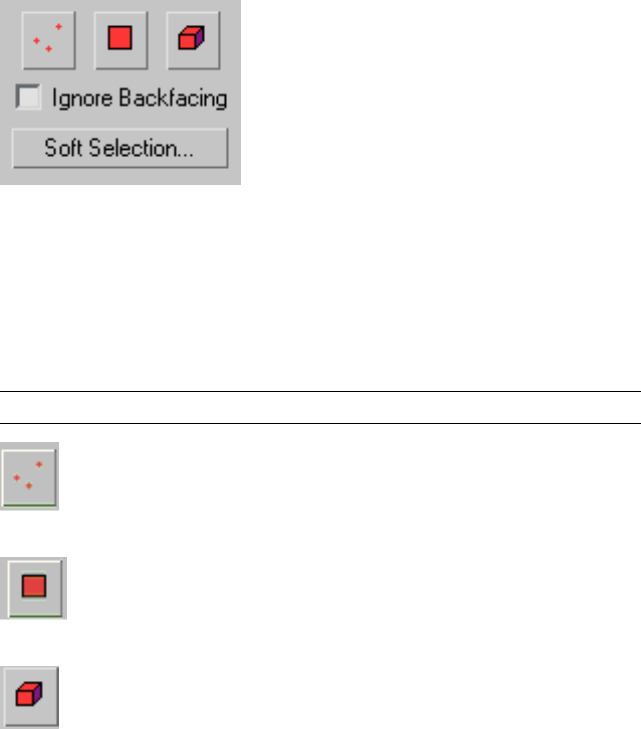
Selection group
Tools in this group let you choose sub-object selection levels. You can select
vertices, faces or elements. Includes the option to ignore backfacing so you
can limit your selection to sub-objects that face toward you, and also provides
access to standard soft selection options.
This creates a mask that will lets you determine what is being affected by your
paint strokes, and any other operations you might apply, such as blurring or
color adjustment. Erase functionality will also honor this mode selection.
NOTE Soft Selection is supported on the various sub-object selection modes.
Select vertex Allows you to select vertices from the currently selected
objects. Once selected, only these vertices will be available for painting.
Select face Allows you to select faces in the currently selected
objects. Once selected, only these faces will be available for painting.
Select element Allows you to select elements in the currently selected
objects. Once selected, only these elements will be available for painting.
Ignore Backfacing When this is on, prevents you from mistakenly selecting
sub-objects facing away from the user.
Soft Selection The same soft-selection options on page 1926 found in Editable
Mesh and Editable Poly are available by clicking this button.
1894 | Chapter 9 Modifiers

Image Adjustment group
Tools in this group allow you to perform overall color adjustment or image
blurring without using the paint brush in the viewport.
Adjust Color Displays the Adjust Color dialog on page 1900 , where
you can find sliders for adjusting HLS or RGB values, preview the adjustment
effect, and apply it.
Blur Smoothes the pixels in the image so there is less contrast and
color difference. Use this to get rid of harsh edges such as shadows created by
the Assign Vertex Colors utility.
Blur Amount spinner Blurs currently selected channel values (for example,
vertex color, alpha) for the currently selected objects. Also supports sub-object
selection of vertices, faces, and elements. With soft selections, the final blurred
value is computed, and then combined with the original color according the
selection; a 50 percent soft selection means that a vertex will become a
fifty-fifty combination of its original color and the blurred color. Successive
clicks of the Blur button will succesively blur the previous results, eventually
washing out painting effects entirely.
Blur is useful for softening vertex color lighting information that is
automatically generated by the Assign Vertex Color utility or rollout. Assign
Vertex Color computes intensities per vertex. This is especially useful for
low-resolution geometry and high-frequency lighting changes.
Blur Brush Lets you apply blurring by using the same
brush techniques and settings that you use to apply color. The Blur Brush
respects sub-object selection and the Blur Strength setting.
VertexPaint Modifier | 1895
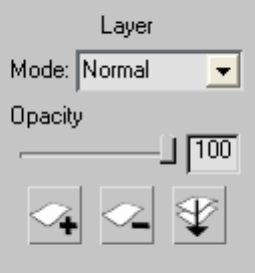
Layers group
Mode The layer mode drop-down list allows you to select a specific operator
for this paint layer. The operator selected affects base color, alpha, illumination,
and other information coming up from layers below it, or from the base object
itself. The chosen operator controls how the incoming color is combined with
any newly painted colors for the current level.
This mode is changeable at any time, without destroying previously painted
information in layers above, below, or in the current paint layer. The following
modes are supported per paint layer:
■Normal The layer color completely overwrites the base color.
■Overlay The color cast is shifted towards the layer color and contrast
might be increased.
It's useful when you want to make an object appear a different color but
in the same lighting conditions. A fully bright or dark channel is never
affected however, so if Red=100% and Green=0% in the base color, then
neither the red nor green channels can be affected by the layer color.
■Screen Each RGB channel is moved towards full brightness, depending
on the layer color. The result is at least as bright (never darker) than the
original. Black is transparent in this mode.
■Multiply Each RGB channel is moved towards zero, depending on the
layer color. The result is at least as dark (never brighter) than the original.
White is transparent in this mode.
■Lighten Whichever color is brighter, the layer or the base, is used as the
output. It operates on the whole color, and not channel-by-channel.
1896 | Chapter 9 Modifiers
■Darken Whichever color is darker, the layer or the base, is used as the
output. It operates on the whole color, and not channel-by-channel.
■Color dodge Emulates the effect of "dodging" a color print in a darkroom;
the result is at least as bright (never darker) than the original.
For each RGB channel, if the layer is at full value in that channel, the
output channel will be at full value. Even if the layer value is less then full
value, the output is still strongly brightened in that channel. For example,
a medium-red layer color will add a significant red brightness to the output.
■Color burn Emulates the effect of "burning" a color print in a darkroom;
the result is at least as dark (never brighter) than the original. For each
RGB channel, if the layer is zero in that channel, the output channel will
be zero. Even if the layer value is above zero, the output is still be strongly
darkened in that channel. For example, a medium red layer color will
significantly reduce blue and green brightness in the output.
The next four Light modes essentially offer compromises between the
destructive effect of Normal Mode and the toning effect of Overlay mode. Try
using medium-value desaturated layer colors, since the light modes can be
too destructive with bright, vivid layer colors. A neutral grey layer color is
transparent in any of the light modes.
■Soft light Very similar to Overlay, but even more gentle, and it does not
tend to increase contrast as much.
■Hard light More like Normal mode than Overlay, it will change color
cast somewhat. It is fairly destructive like Normal mode, especially with
bright layer colors.
■Vivid light Brighter layer colors produce a Color Dodge effect, while
darker layer colors produce a Color Burn effect, although the effect is
generally weaker than Dodge or Burn.
■Linear light For each RGB channel, if the layer color is more than 50
percent bright in that channel, the output will be brightened, and if the
layer is less then 50 percent bright, the output will be darkened. As an
example, if you want the top of your image to be twice as bright, and the
bottom to be half as bright, use a gradient from 75 percent gray to 25
percent gray, top to bottom.
VertexPaint Modifier | 1897
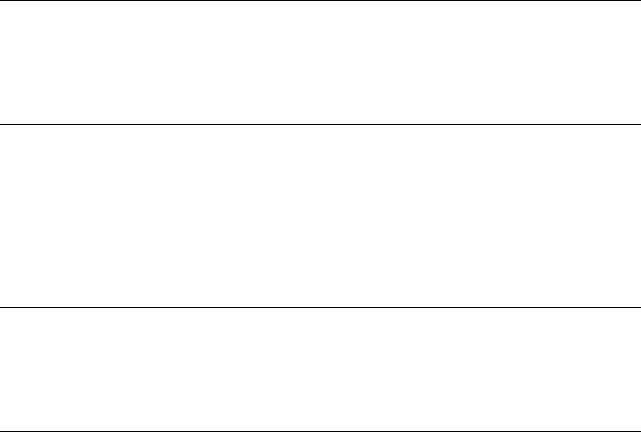
The next four modes are used to control the HSV channel values of the image
instead of using RGB channel value.
■Hue The output color has the saturation and value of the base color, with
the hue of the layer color.
■Saturation The output has the hue and value of the base color, and the
saturation of the layer color.
■Color The output has the value of the base color, and the hue and
saturation of the layer color.
■Luminosity The output has the hue and saturation of the base color, and
the brightness value of the layer color.
NOTE Using the show end result button in the modifier stack for the current paint
layer will allow you to interactively paint under any over laying paint layers (vertex
paint modifiers that are above the current one in the object’s modifier stack). This
allows you to see the final results of your paint strokes for any paint layer in the
stack.
Opacity Slider Allows you to set the opacity of the current vertex paint layer,
from 0 to 100 percent. 100 percent Opacity means that the current layer is
entirely opaque: you cannot see through it to the layer directly under it or to
the base vertex colors of the objects being painted.
The opacity of a layer is animatable. Simply turn on Auto Key, move the time
slider and adjust the spinner value. This will set a keyframe.
NOTE If you painted on the layer with a brush opacity less than 100 percent, then
colors stored in the layer can already be less than full opacity, and the final opacity
at any vertex is a product of the two values. If you vertex had only 50 percent
opacity worth of paint applied to it, and the layer is 50 percent opaque, then the
vertex will appear 25 percent opaque overall.
Be aware that the paint opacity is different from the vertex alpha channel.
Values less than 100 percent incrementally reveal any vertex color, alpha
information, and so on, coming from vertex paint layers beneath it, or the
base object's original information. Opacity values can be changed for the
current layer at any time. Since vertex paint layers are preserved in the modifier
stack you can return to a particular layer at any time and adjust its opacity to
tune an object’s final appearance.
1898 | Chapter 9 Modifiers
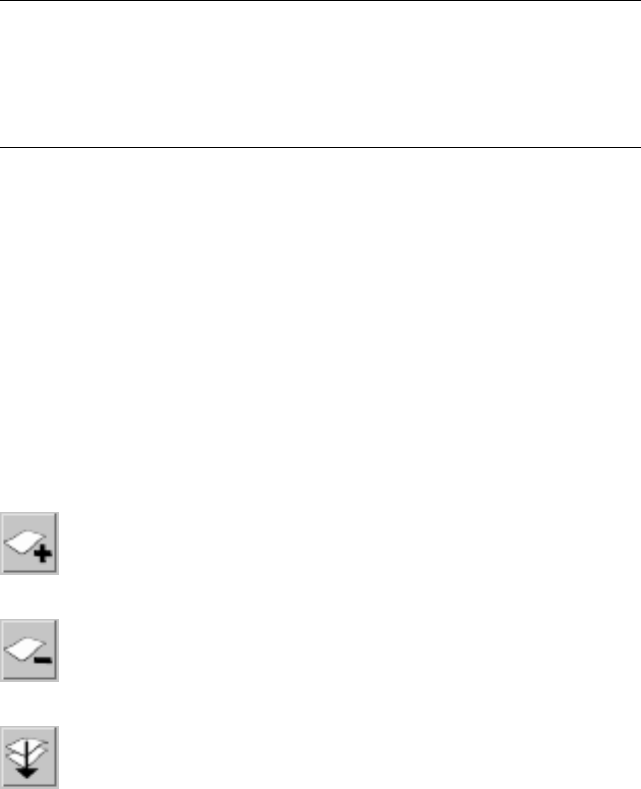
NOTE The opacity for a specific paint layer should not be confused with “alpha”
information for a given vertex. Opacity controls the mixing of painted information
in the modifier stack for the currently active map channel (whether it be color
information, alpha, illumination, or any arbitrary map channel from 1 to 99). Alpha
Channel information (by convention) is intended to be used specifically to indicate
the transparency of all combined color information for a given vertex.
Another way to think about the opacity slider is that it is identical to the
amount spinner. The difference between them is that opacity is for the entire
layer, where as amount is for the current brush stroke (between a mouse down
and mouse up period when painting). Changing the amount spinner after
painting does not affect what is already displayed on the screen; where
changing the opacity layer does. In the end, the current vertex paint layer
being applied generates a final color that is the combine result of amount and
opacity. The whole concept should be quite natural to any Adobe Photoshop
user. However, Photoshop is able to display a light grey and dark grey quilt
as a background to give a visual cue about layer opacity, whereas 3ds Max
does not support this same display cue. So in 3ds Max, more attention is
required of the artist to understand the opacity of each vertex on each layer.
Opacity numeric entry field Allows you to enter an opacity amount. Range=0
(completely transparent) to 100 (totally opaque).
New Layer Click to create a new VertexPaint layer. Clicking new
layer displays a New Layer dialog.
Delete Layer Click to delete the current VertexPaint layer. This
removes the modifier from the stack.
Condense to single layer Click to condense all vertex coloring into
a single layer in the current VertexPaint modifier. Use this to modify existing
vertex coloring within the current modifier.
Condensing layers is a two-part operation: First 3ds Max adds a new
VertexPaint modifier to the stack, combining vertex coloring applied directly
with Editable Mesh/Polygon and from previous VertexPaint layers according
to the settings described above. Second, it deletes any prior VertexPaint
modifiers.
VertexPaint Modifier | 1899
If Preserve Layer has been turned on for a particular VertexPaint layer, then
its colors are “baked” into the new VertexPaint modifier, but the preserved
layer isn't deleted from the stack.
Adjust Color Dialog (VertexPaint Modifier)
Select an object. > Modify panel > Modifier List > VertexPaint > VertexPaint
Paintbox > Click the Adjust Color button.
Select an object. > Modifiers menu > Mesh Editing > Vertex Paint > VertexPaint
Paintbox > Click the Adjust Color button.
Select an object. > Utilities panel > More > Assign Vertex Colors > Click Assign
to Selected > Modify panel > Modifier List > VertexPaint > VertexPaint Paintbox
> Click the Adjust Color button.
The Adjust Color dialog lets you adjust the color of currently selected vertices.
If there is no active vertex sub-object selection, it affects all vertices equally.
1900 | Chapter 9 Modifiers
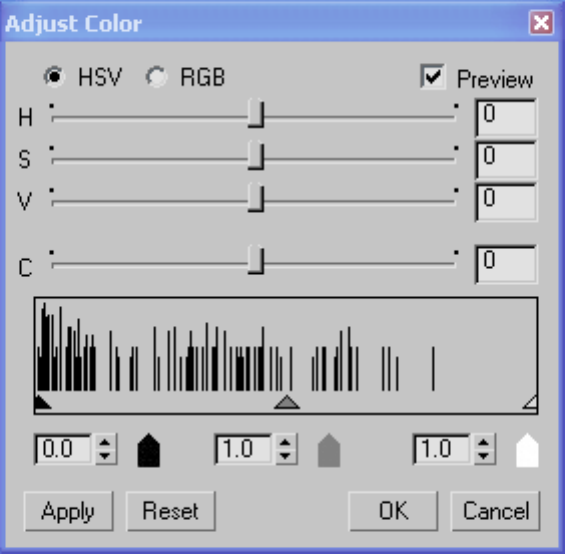
Interface
■HSV (The default.) When chosen, the first three sliders are labeled HSV,
and adjust the colors' hue, saturation, and value.
■RGB When chosen, the first three sliders are labeled RGB, and adjust the
colors' red, blue, and green components.
See Red, Green, Blue / Hue, Saturation, Value on page 7908 .
Preview When on, vertex color adjustments are previewed interactively in
shaded viewports (provided that on the Paintbox, Vertex Color Display -
Unshaded or Vertex Color Display - Shaded is active). Default=on.
Contrast slider Lets you adjust the contrast of the vertex colors.
Histogram and Input-Level Spinners
Histogram Graphically shows the distribution of colors in the vertex
selection, as well as the current shadow, gamma, and highlight input levels.
VertexPaint Modifier | 1901

The shadow, gamma, and highlight input levels can help you adjust 3ds Max
viewport color to better match your target hardware display (such as a game
engine).
Shadow level Adjusts the level of shadow display.
Gamma level Adjusts the gamma display. This value is a gamma correction
on page 7798 value.
Highlight level Adjusts the level of highlight display.
When you adjust a level, the corresponding arrow moves on the histogram,
to indicate the current setting. (However, you can't graphically drag the
arrows.)
Apply Click to apply the current settings to vertex colors, without closing
the dialog.
Reset Click to restore dialog settings to their defaults.
Color Palette (VertexPaint Modifier)
Select an object. > Modify panel > Modifier List > VertexPaint > VertexPaint
Paintbox > Click the Palette button.
Select an object. > Modifiers menu > Mesh Editing > Vertex Paint > VertexPaint
Paintbox > Click the Palette button.
Select an object. > Utilities panel > More > Assign Vertex Colors > Click Assign
to Selected > Modify panel > Modifier List > VertexPaint > VertexPaint Paintbox
> Click the Palette button.
The VertexPaint modifier's Color Palette lets you create and maintain color
palettes for use with vertex paints. You can save or load palettes as Color
Clipboard (CCB) files, which are also used by the Color Clipboard utility on
page 337 .
NOTE The Palette remembers the last palette you used. This is not affected by
File > Reset. However, the active palette is saved in the file 3dsmax.ini on page
51 so deleting the INI file causes the palette to revert to the default grayscale
palette.
1902 | Chapter 9 Modifiers

Procedures
To use the palette to choose a color:
■On the List or Swatch panel, click the color.
The color appears as the active color on the VertexPaint Paintbox, in the
swatch just below the Erase button.
To change the color of a color swatch:
1Double-click the swatch.
A Color Selector on page 331 appears.
2Use the Color Selector to change the swatch's color.
This version of the Color Selector is modeless on page 7849 , so after
choosing a color you can either close it, or leave it open to change another
swatch.
To use the color picker:
1In the Palette's List panel, highlight the name of a color.
2 Click the Color Picker button to turn it on.
The cursor changes to an eyedropper icon.
3Without depressing the mouse button, drag to an area where you want
to pick a color.
You can obtain colors from viewports, the 3ds Max user interface, or
anywhere on the Windows desktop.
4When you depress the mouse button, the picker obtains the color below
the cursor. You can drag while the mouse button is depressed. While you
do, the color swatch in the palette and the larger swatch on the Paintbox
update.
5Release the mouse to pick the color you want.
The color in the Palette and the active color in the Paintbox are both
updated.
To change a color's name:
1In the List panel, click the name twice (more slowly than a double-click).
VertexPaint Modifier | 1903
The name changes to an editable field.
2Enter a new name or edit the existing one, and then press Enter.
Press Esc to cancel the name change.
To save a palette to a file:
1Right-click the List panel or the Swatch panel.
The Palette's pop-up menu on page 1907 appears.
2Choose Save As from the menu.
A Save Color Clipboard File dialog appears.
3Use the dialog to give the palette a name (and optionally, a directory
location other than the default), and then click OK to save the CCB file.
To load a palette from a file:
1Right-click the List panel or the Swatch panel.
The Palette's pop-up menu on page 1907 appears.
2Choose Load from the menu.
A Load Color Clipboard File dialog appears.
3Choose the CCB palette file you want to load, and then click OK.
1904 | Chapter 9 Modifiers
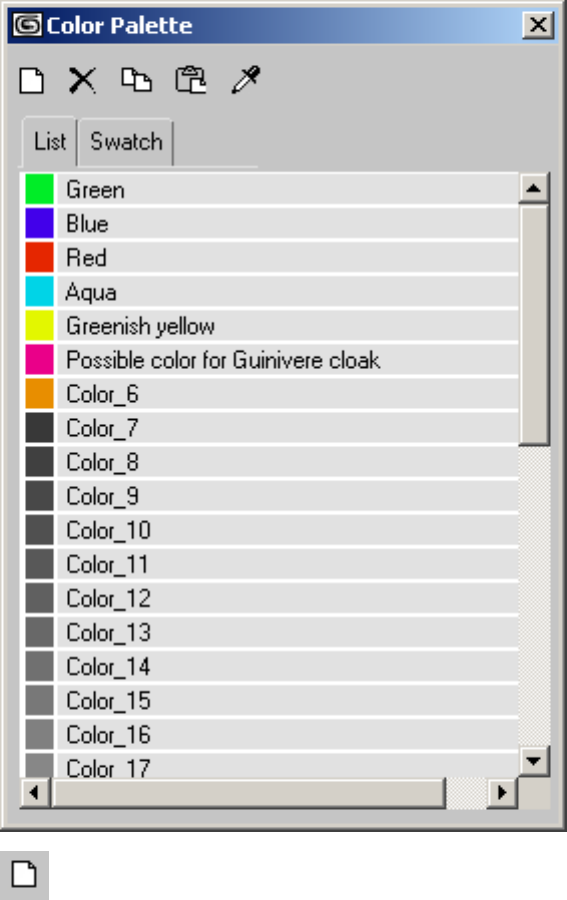
Interface
New Click to add a new color to the palette.
The only limit to the number of colors a palette can have is a file size or
memory limitation.
VertexPaint Modifier | 1905

Delete Click to delete the active color.
Copy Click to copy the active color.
Paste Click to paste a copied color to the active swatch.
Color Picker Highlight a color in the palette, turn this button on to
activate the picker, then drag anywhere on the Windows desktop. The color
is picked when you release the mouse. (See the procedure “To use the color
picker,” above.)
List panel Displays the colors in the palette, along with their names.
Swatch panel Displays the colors in the active palette. The swatch panel
doesn't list the names of colors, but each color's name appear as a tooltip when
the mouse is over the swatch.
Swatch panel showing default grayscale palette
1906 | Chapter 9 Modifiers
List and Swatch Panel Right-Click Menu
When you right-click the List panel or the Swatch panel, a pop-up menu
appears.
Copy Copies the active color.
This is the same as clicking Copy.
Paste Pastes a color to the active swatch.
This is the same as clicking Paste.
New Adds a color to the palette.
This is the same as clicking New.
Delete Deletes the active color.
This is the same as clicking Delete.
Save As Displays a Save As dialog on page 6724 that lets you enter a name
for the CCB file, then save it.
By default, Color Clipboard files are saved in the \images directory below the
3ds Max root directory.
Load Displays a file open dialog that lets you choose a CCB palette file to
load.
View Displays a text-editor window with the current CCB palette file. If no
CCB file has been loaded or saved, choosing View has no effect.
The first 12 lines of a CCB file contain integer RGB values. This part of the
file is used by the Color Clipboard utility on page 337 and ignored by the
Color Palette dialog. The remaining lines of the file include floating-point
RGB values and color names.
Painter Options Dialog
Modify panel > Skin modifier > Parameters rollout > Weight Properties group
> Painter Options button
VertexPaint modifier > Floating Vertex Paintbox > Brush Options button
Edit/Editable Poly object or Poly Select modifier > Soft Selection rollout > Paint
Soft Selection group > Brush Options button
Edit/Editable Poly object > Paint Deformation rollout > Brush Options button
VertexPaint Modifier | 1907
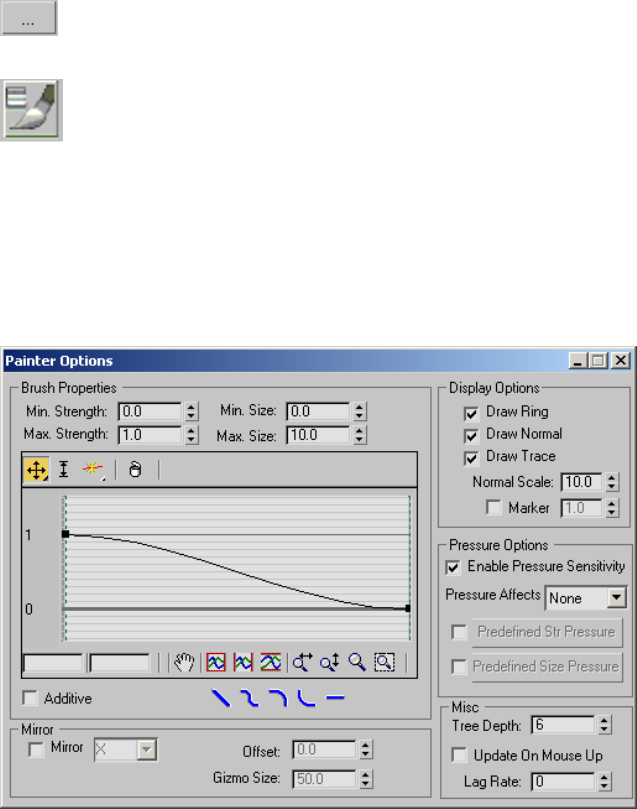
The Painter Options dialog for the Skin modifier appears when you
click the Painter Options button.
This same dialog is used by the VertexPaint modifier to control the
brush envelope, use pressure sensitivity, or enter mirror painting mode. The
dialog is accessed through the Brush Options button on the floating Vertex
Paintbox.
The dialog is also used by the Paint Soft Selection and Paint Deformation tools
available for poly objects.
Interface
Brush Properties group
Min. Strength Sets the minimum vertex weight to paint.
Max. Strength Sets the maximum vertex weight to paint.
Min. Size Sets the minimum size for the paint gizmo.
1908 | Chapter 9 Modifiers
Max. Size Sets the maximum size for the paint gizmo.
Brush strength falloff curve This graph determines how the brush weight
falls off as the distance increases from the center of the brush. The controls
on this graph are similar to those on a loft deformation dialog on page 756 .
Additive When on, brush strokes add to existing vertex weights.
Quick Brush Falloff Types Set the brush falloff to linear, smooth, slow, fast,
or flat.
Display Options group
The options in this group determine the appearance of the paint gizmo.
Draw Ring A ring appears as part of the paint gizmo.
Draw Normal A normal arrow appears as part of the paint gizmo.
Draw Trace Draws a trace (temporary mark) that shows the path of the brush
stroke on the surface.
Normal Scale Sets the scale of the normal arrow in the paint gizmo.
Marker Displays a circular marker at the end of the normal arrow. The value
next to Marker sets the height of the marker.
Pressure Options group
Enable Pressure Sensitivity Turns on pressure sensitivity for the paint gizmo
brush.
Pressure Affects Selects the brush parameter to be affected by pressure
sensitivity. Choose from four options: None, Strength, Size, or both size and
strength (Size/Str).
Predefined Str Pressure Turn this option on to use a predefined strength
pressure. Click the button to view and edit the falloff curve for the strength.
Predefined Size Pressure Turn this option on to use a predefined size pressure.
Click the button to view and edit the falloff curve for the size.
Mirror group
Mirror Turn this option on to mirror the paint gizmo on the other side of
the object. Choose an axis from the drop-down menu. The paint gizmo is
mirrored about the selected axis in the world coordinate system.
Offset Offsets the mirror plane by the value you specify.
VertexPaint Modifier | 1909
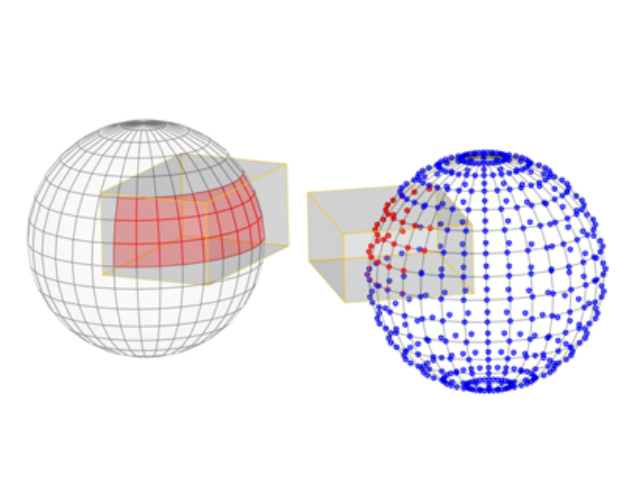
Gizmo Size Changes the mirror gizmo size to a value you specify.
Misc group
Tree Depth Determines the size of the quad tree used for hit testing. Tree
Depth relates to the amount of memory set aside for weight painting. Larger
values mean faster interaction but more memory use.
Update On Mouse Up Prevents the system from updating viewports when
the mouse button is pressed. This can save time in your workflow.
Lag Rate Determines how often the stroke updates the painted surface.
Higher values update the surface less often.
Volume Select Modifier
Modify panel > Make a selection. > Modifier List > Vol. Select
Make a selection. > Modifiers menu > Selection Modifiers > Volume Select
Faces and vertices selected using box volumes.
1910 | Chapter 9 Modifiers
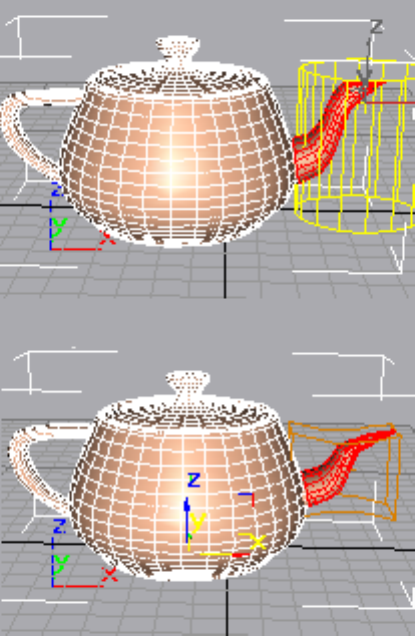
The Volume Select modifier lets you make a sub-object selection of vertices
or faces for passing up the stack to another modifier or modifiers. The
sub-object selection is completely separate from the underlying parametric
geometry of the object. Like other selection methods, Volume Select works
with single or multiple objects.
Volume Select lets you use one of three gizmos or another object to define a
volume of space as the selection area, to which you can then apply modifiers.
You can move the selection over an object and animate it.
When applied, Volume Select begins with the current geometry in the object's
stack, whether it's a whole object or a sub-object selection (for example, from
an Edit Mesh on page 1283 or another Volume Select modifier).
Top: Original mesh with select gizmo showing
Bottom: Modification made after applying Volume Select modifier
Volume Select Modifier | 1911
Patches
As of version 4, patch objects coming up the modifier stack are not converted
to a mesh by this modifier. A patch object input to the Volume Select modifier
retains its patch definition. Files that contain patch objects with the Volume
Select modifier from previous versions of the software will be converted to
meshes to maintain backward compatibility.
Scaling Compatibility
The Volume Select gizmo scales along with its object. Thus, if you apply a
Volume Select modifier, and then change the scale of your object (with the
toolbar Scale function on page 892 ) the selection doesn't change. In other
words, all three transforms affect the Volume Select gizmo and its object
identically.
Volume Select Center
The Volume Select modifier has a center as well as a gizmo. This lets you alter
the center for non-animated transforms. However, if you animate a rotation
about the offset center, you achieve animation of both rotation and translation.
Procedures
To apply and use volume selection:
1Select an object and apply the Vol. Select modifier.
The Parameters rollout appears.
2In the Stack Selection Level group, choose Object, Vertex, or Face to
specify the kind of geometry you want to work with.
3In the Select By group, choose one of the four volume types: Box, Sphere,
Cylinder, or Mesh Object.
If you choose Mesh Object, you should then click the None button and
select an object to use as the selection volume.
4Choose a selection method and type (defined in the following Interface
section). You can change these choices as you work, depending on the
particular selection you're trying to make.
1912 | Chapter 9 Modifiers
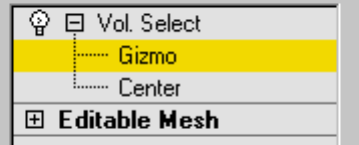
5Once the selection is complete, you can do the following:
■Apply modifiers to the selection.
■Transform the Volume Select gizmo at the sub-object level, changing
the selection in the process.
■Combine these options. See the following example.
Example: To animate a volume selection:
1Apply Volume Select to an object.
2Make a sub-object selection of the object's geometry at Face or Vertex
level, and apply a geometric modifier, such as Bend on page 1139 , to the
selection.
3Move to a nonzero frame and begin animation. Adjust parameters on
the geometric modifier, then move to another frame.
4In the stack, return to the Volume Select modifier. Choose the Volume
Select gizmo sub-object. Move the gizmo and its geometry selection to
another part of the object.
5Repeat this process on other frames. Optionally, you can return to the
geometric modifier and change its parameters at any frame.
During playback, you see the effect of an animated geometric modifier moving
over the object.
Interface
Modifier Stack
Gizmo sub-object You can transform and animate the gizmo to change the
selection. Translating the gizmo translates its center an equal distance. Rotating
and scaling the gizmo takes place with respect to its center.
Volume Select Modifier | 1913
Center sub-object You can translate and animate the center, which affects
rotation or scaling of the Volume Select modifier's gizmo.
For more information on the Stack Display, see Modifier Stack on page 7427 .
1914 | Chapter 9 Modifiers

Parameters rollout
Volume Select Modifier | 1915
Stack Selection Level group
Object/Vertex/Face Volume Select provides three selection levels. Vertex
and Face levels put the modifier stack in sub-object selection. You can make
one sub-object selection for each Volume Select modifier. You can then toggle
the one selection between Face and Vertex level to send either up the stack.
Object (top) level lets you modify the whole object while retaining any
sub-object selection.
Selection Method group
Replace Clears any selection passed up the stack to the Volume Select
modifier, and then selects geometry within the volume.
Add Selects all geometry within the volume, adding to any previous selection.
Subtract Deselects all geometry within the volume.
Invert Reverses the entire selection set. Geometry that was unselected
becomes selected, and vice versa.
Selection Type group
Lets you determine whether selected faces are wholly or partially within the
defined volume when you set Stack Selection Level to Face.
Window Selects only faces with all three vertices within the selection volume.
Crossing Selects faces with only one vertex within the selection volume.
Select By group
These controls let you define the selection with a primitive, a mesh object, or
by surface characteristics.
Volume: Box/Sphere/Cylinder To define the selection space using a standard
primitive-shaped gizmo, choose one of these. You can then scale, rotate, or
move the gizmo anywhere around the object.
Volume: Mesh Object Choose this option to use another object to define
the selection space. After choosing Mesh Object, click the button below it
(labeled "None" by default), and then select an object to use as the volume.
Besides mesh objects, you can use patch objects and NURBS objects. In
addition, if you turn on Soft Selection rollout > Use Soft Selection, you can
use spline objects and particle systems to define the selection. This latter
option is quite powerful because the selection changes as the particles move.
1916 | Chapter 9 Modifiers
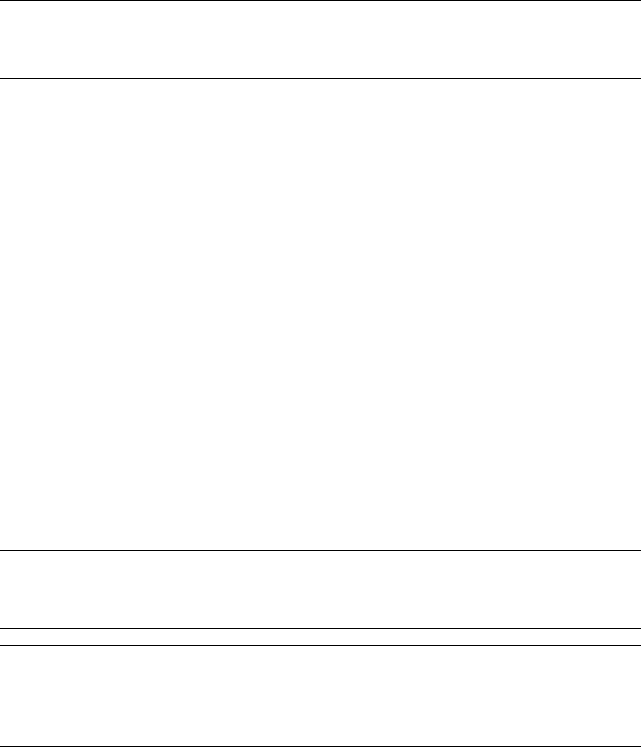
Mesh object button Click this button, then select an object to define the
selection space. You don't need to choose Mesh Object first, but you do need
to choose Mesh Object to use the object as a volume. After you select an object,
its name appears on the button.
This button is labeled "None" if no object has been chosen.
NOTE The selection depends on a volume intersecting the object. If a gizmo or
object is scaled down and moved inside an object, no selection occurs because
no geometry is within the volume of the gizmo.
Surface Features Defines the selection by surface characteristics instead of
a geometric volume. While this doesn't have much to do with volume, it was
added because Volume Select is a procedural modifier, whereas Mesh Select
on page 1455 is explicit. Now, even if your topology changes, Volume Select
will consistently select the faces or vertices using a particular material or
smoothing group.
Indicate which type of surface characteristic to base selection on by choosing
one of the following:
Material ID Specifies a material ID. All faces or vertices using the ID indicated
by the spinner value are selected.
Sm Group Specifies a smoothing group. All faces or vertices using the ID
indicated by the spinner value are selected.
Texture Map Specifies a texture map from the scene. Click the map button
(labeled "None" by default) to choose a texture map to use for selection. All
faces or vertices using that texture map will be selected. When using the
Texture Map option, you can also specify a mapping channel or the vertex
color channel using the Map/Vertex Color radio buttons and spinner.
NOTE You must apply mapping to the object below Vol. Select in its stack for the
Texture Map selection to work. That is, the Vol. Select modifier must have mapping
coordinates passed up the stack so it can use a texture map for selection.
NOTE If you set Selection Type to Window, vertices will be selected if all the faces
they touch use the specified material or smoothing group. If you set Selection
Type to Crossing, vertices will be selected if they touch any face using the specified
material or smoothing group.
Alignment group
These controls are generally used when the gizmo has been transformed out
of its original orientation to the object.
Volume Select Modifier | 1917

Fit Resizes the gizmo to fit around the object or previous selection in the
stack. Maintains any previous rotation.
Center Recenters the gizmo on the object or previous selection in the stack.
Maintains any previous scale or rotation.
Reset Returns the gizmo to its default size and orientation. Cancels the effect
of all previous transforms.
Auto Fit When on, automatically adjusts the gizmo size and shape to fit the
object as you change the underlying topology (for example, transforming
vertices).
Soft Selection rollout
These controls, available only at the Vertex stack selection level, let you set a
gradual falloff of influence between selected and unselected vertices. See Soft
Selection Rollout (Edit/Editable Mesh) on page 1926 .
NOTE Soft Selection does not apply to materials or smoothing groups. However,
if there was already a weighted selection passed up the stack, a Volume Select set
to Material or Smoothing Group mode and not set to Replace will preserve the
selection.
Wave Modifier
Modify panel > Make a selection. > Modifier List > Object-Space Modifiers >
Wave
Make a selection. > Modifiers menu > Parametric Deformers > Wave
The Wave modifier produces a wave effect in an object's geometry. You can
use either of two waves, or combine them. Wave uses a standard gizmo and
center, which you can transform to increase the possible wave effects.
The Wave on page 2695 space warp has similar features, and is useful for
applying effects to a large number of objects.
1918 | Chapter 9 Modifiers
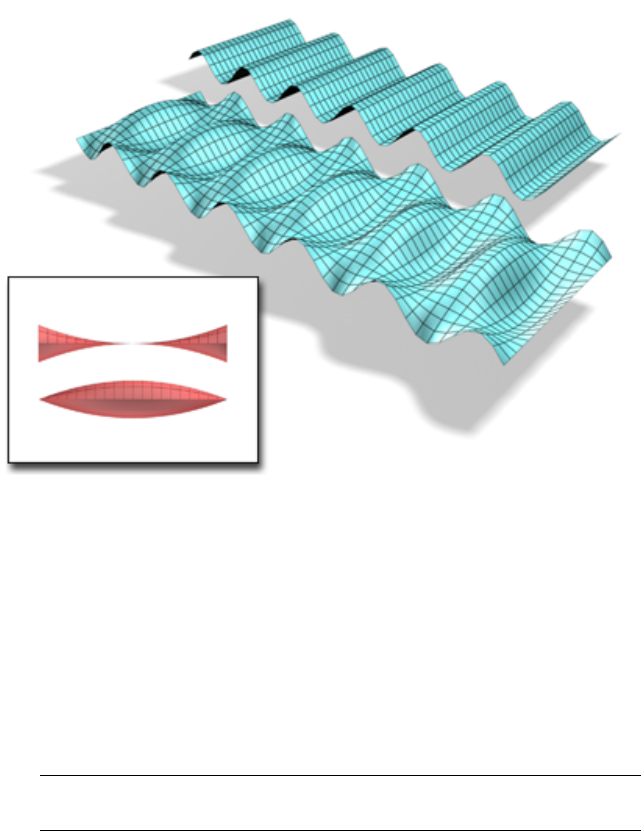
An object with the Wave modifier applied. Amplitude 1 and 2 can be changed, creating
different profiles.
See also:
■Ripple Modifier on page 1583
Procedures
To make an object wavey:
1Select an object and apply the Wave modifier.
TIP To see the effect clearly, apply Wave to a broad, flat object that has many
segments.
2Set one or both values for amplitude, or the vertical height of the wave
in current units.
Amplitude 1 produces a sine wave from one edge to the other, while
Amplitude 2 creates a wave between the opposite edges. Switching a value
from positive to negative reverses the position of peaks and troughs.
Wave Modifier | 1919
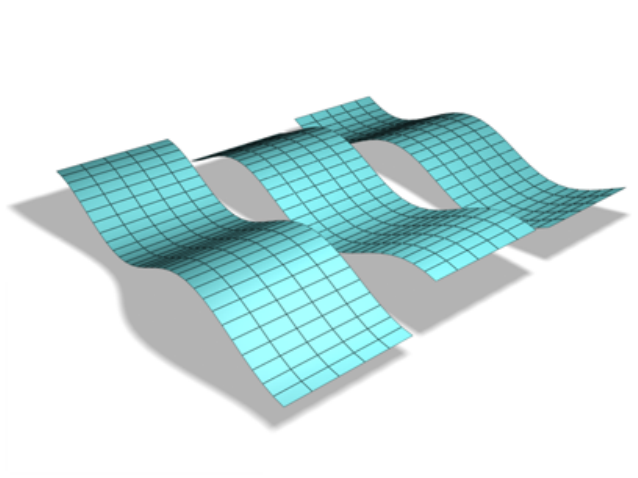
3Set the length of the wave and the distance in current units between
crests of both waves.
The greater the length, the smoother and more shallow the wave for a
given amplitude.
To add a phase effect:
■Set a phase value to shift the wave pattern over the object. Positive numbers
move the pattern in one direction, while negative numbers move them in
the other. This effect is especially clear when animated.
Phase effect on a wave
To add a decay effect:
■Set a decay value to increase or decrease the amplitude.
A decay value decreases the amplitude as the distance from the center
increases. As the Decay value increases, the wave is concentrated at the
center and flattens until it disappears (completely decays).
1920 | Chapter 9 Modifiers
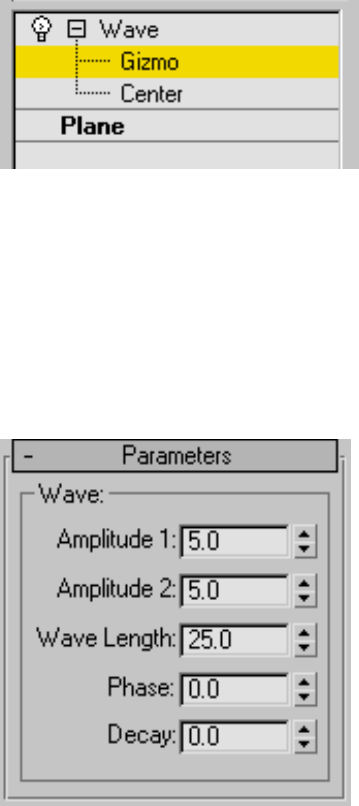
Interface
Modifier Stack
Gizmo At this sub-object level, you can transform and animate the gizmo
like any other object, altering the effect of the Wave modifier. Translating the
gizmo translates its center an equal distance. Rotating and scaling the gizmo
takes place with respect to its center.
Center At this sub-object level, you can translate and animate the center,
altering the Wave gizmo's shape, and thus the shape of the wavy object.
For more information on the stack display, see Modifier Stack on page 7427 .
Parameters rollout
Amplitude 1/Amplitude 2 Amplitude 1 produces a sine wave along the
gizmo's Y axis, while Amplitude 2 creates a wave along the X axis (although
peaks and troughs appear in the same direction with both). Switching a value
from positive to negative reverses the positions of peaks and troughs.
Wave Modifier | 1921

Wave Length Specifies the distance in current units between the crests of
both waves.
Phase Shifts the wave pattern over the object. Positive numbers move the
pattern in one direction, while negative numbers move it in the other. This
effect is especially clear when animated.
Decay Limits the effect of the wave generated from its origin. A decay value
decreases the amplitude at increasing distance from the center. As this value
increases, the wave is concentrated at the center and flattened until it
disappears (completely decays).
XForm Modifier
Modify panel > Make a selection. > Modifier List > Object-Space Modifiers >
XForm
Make a selection. > Modifiers menu > Parametric Deformers > XForm
Use the XForm (short for Transform) modifier to apply transformations (Move,
Rotate, Scale) to objects. The XForm has two main functions:
■To animate transformations of a sub-object selection. You can also animate
the position of the modifier's center.
■To transform an object at any point in the stack.
NOTE The Linked XForm modifier on page 1440 is a variant of XForm. Linked
XForm has no gizmo or center of its own. Instead, a given selection is "linked"
to another object, which supplies its gizmo and center. Using Linked XForm,
you can link a sub-object selection directly to the coordinate system of another
object.
Using XForm
XForm provides a gizmo and center for any geometry it receives from the stack
whether it's a sub-object selection or the whole object. XForm has no
parameters. When you move the XForm modifier gizmo, the center moves
with it, along with the geometry.
You can reposition the XForm center separately from the gizmo.
1922 | Chapter 9 Modifiers

Offsetting XForm Center
At the XForm Center sub-object selection level, only the Move transform is
available. This lets you reposition the center. When you return to the Gizmo
level, you can rotate or scale the selection around the offset center. The center
position and gizmo transformations are all animatable.
Scaling with XForm
When you scale an object with a toolbar Scale tool, the software applies the
effect to the object after all the modifiers in the stack. In some cases you might
want to squash or stretch an object before applying geometric or edit modifiers.
XForm makes this possible.
By applying XForm and scaling its gizmo, you can place the scaling operation
anywhere in the stack.
Using XForm with Volume Select
You can combine the XForm and Volume Select modifiers on page 1910 to
animate sub-object selections. This combination makes it possible to animate
both the effect of a modifier on the selection (Volume Select) and a
transformation of that selection (XForm).
Procedures
To use the XForm modifier:
1Choose a location in an object's stack and apply the XForm modifier.
The Gizmo sub-object level is automatically activated. All transform
buttons are available on the toolbar.
2 Move to a nonzero frame and turn on Auto Key to animate
the next step.
3Transform the gizmo.
As you transform the gizmo, the selected geometry is transformed with
it.
To use XForm as a scaling modifier:
1Apply XForm to an object or a sub-object selection.
XForm Modifier | 1923

2Scale the gizmo.
The rescaled geometry becomes "part of the stack" because the scale
transform is carried with XForm, instead of being applied after the
modifiers.
Interface
This modifier has no parameters, but you can transform the XForm gizmo
and the XForm center. If you switch the selection level to the XForm center,
only the Move transform is available. This lets you offset the center and
transform the gizmo around it. Both offset and gizmo transformations are
animatable.
1924 | Chapter 9 Modifiers
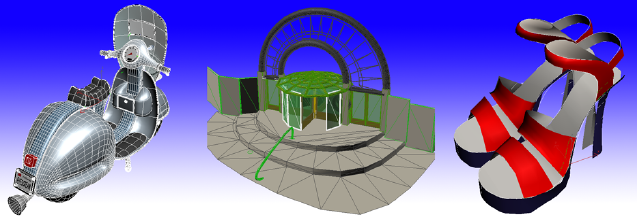
Surface Modeling
Surface modeling is more free form than geometric (parametric) modeling. Although you can
create Patch and NURBS primitives from the Create panel, more often a surface model begins
when you use the quad menu on page 7300 or the modifier stack on page 7427 to “collapse” a
parametric model to some form of editable surface. Once you have done so, a variety of tools
let you shape the surface. A lot of surface modeling work is done by editing sub-objects on
page 7939 of the surface object.
Three types of surface models: patch (left); mesh (center); NURBS (right)
See also:
■Patch Grids on page 1982
■Editable Patch Surface on page 1934
■Editable Mesh Surface on page 1990
■Editable Poly Surface on page 2038
■NURBS Modeling on page 2152
■Subdivision Surfaces on page 1926
■Tool for Low-Polygon Modeling on page 2492
10
1925
Subdivision Surfaces
A subdivision surface is a surface that has been divided into more faces while
retaining the object's general shape. You perform subdivision to add more
detail to an object, or to smooth it out.
You can create a subdivision surface by applying a modifier to an object. 3ds
Max supports two kinds of subdivision surfaces:
■The HSDS modifier on page 1420 provides hierarchical subdivision surfaces.
■The MeshSmooth modifier on page 1460 and TurboSmooth modifier on
page 1750 provide smoothing.
Both these modifiers work best as finishing tools for models.
The Interface on page 2119 for an Editable Poly object on page 2038 allows you
to add a subdivision surface to this type of object without the use of a modifier.
Soft Selection Rollout
Select an editable patch, editable mesh, editable poly, editable spline, an object
that has an Edit Mesh, Edit Patch, or Edit Spline modifier applied to it, or an
object that has a comparable Select modifier applied to it. > Modify panel >
Choose a sub-object level. > Soft Selection rollout
The Soft Selection controls allow you to partially select sub-objects in the
vicinity of an explicit selection. This causes the explicit selection to behave
as if surrounded by a "magnetic field." Partially selected sub-objects within
the field are drawn along smoothly as you transform the sub-object selection;
the effect diminishes with distance or the “strength” of the partial selection.
This falloff is visible in the viewports as a color gradient surrounding the
selection, conforming to the first part of the standard color spectrum: ROYGB
(red, orange, yellow, green, blue). Red sub-objects are those you select explicitly.
The highest-value soft-selected sub-objects are reddish-orange; they have the
same selection value as red sub-objects, and respond the same way to
manipulation. Orange sub-objects have a slightly lower selection value, and
respond to manipulation a bit less strongly than do red and reddish-orange
vertices. Yellow-orange sub-objects have an even lower selection value, and
then yellow, green-yellow, and so on. Blue sub-objects are effectively unselected
1926 | Chapter 10 Surface Modeling
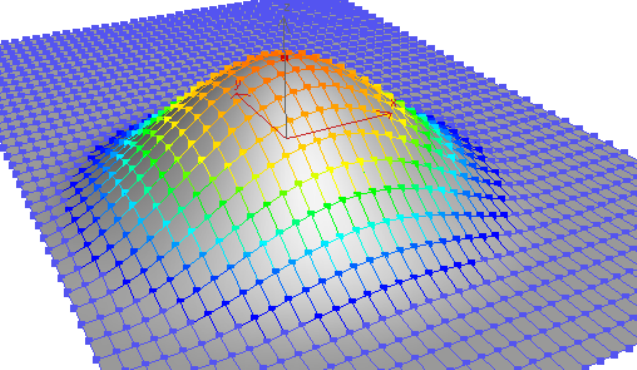
and don't respond to manipulation, except as required by neighboring
soft-selected sub-objects.
Normally, you designate a soft selection procedurally, by setting parameters
and then selecting sub-objects. You can also “paint” a soft selection explicitly
on poly objects. See Paint Soft Selection group on page 1930 .
By default, the soft-selection region is spherical without regard to geometric
structure. Alternatively, you can use the Edge Distance option on page 1928
to limit the selection to vertices in contiguous faces.
If a sub-object selection is passed up the modifier stack, and Use Soft Selection
is on, the results of modifiers that deform the object, such as Bend and XForm,
are affected by the Soft Selection parameter values.
The controls in this dialog let you modify Soft Selection parameters. All
sub-object levels share the same Soft Selection parameter values. Soft Selection
is available for NURBS, mesh, poly, patch, and spline objects.
Soft selection colors and effect on the surrounding area
Soft Selection Rollout | 1927
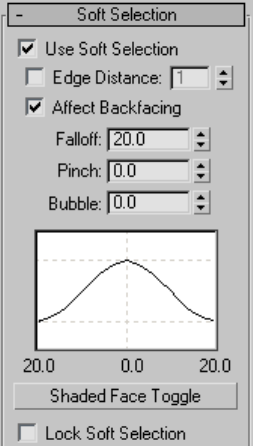
Interface
Use Soft Selection Affects the action of Move, Rotate, and Scale functions
at sub-object levels of the editable object or Edit modifier, as well as the action
of deformation modifiers applied to the object if they are operating on a
sub-object selection (the latter also applies to the Select modifiers). When on,
the software applies a spline curve deformation to the unselected sub-objects
surrounding the selection you transform. To take effect, this check box must
be on before transforming or modifying the selection.
Edge Distance When on, limits the soft-selection region to the specified
number of edges between where you select and the maximum extent of the
soft selection. The affected region is measured in terms of "edge-distance"
space, along the surface, rather than real space.
This option is useful in cases where you want to select only contiguous sections
of geometry. For example, if a bird's wing is folded back against its body,
selecting the wing tip with Soft Selection would affect body vertices as well.
But if you turn on Edge Distance, set the numeric value to the distance (in
edges) along the wing that you wish to affect, and then set Falloff to an
appropriate value, selecting and then moving the wing tip would move only
the wing geometry.
Affect Backfacing When on, deselected faces whose normals face in the
opposite direction to the average normal of the selected sub-objects are affected
1928 | Chapter 10 Surface Modeling
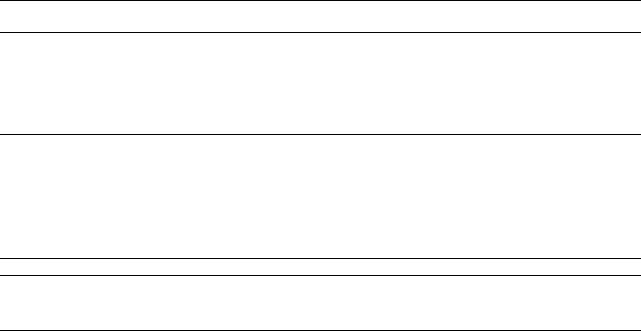
by the soft-selection influence. In the case of vertices and edges, this applies
to the normals of faces to which they're attached. Turn off Affect Backfacing
when you want to manipulate faces of a thin object, such as a thin box, but
don't want to affect faces on the other side of the object.
NOTE Affect Backfacing is not available when editing splines.
Falloff Distance in current units from the center to the edge of a sphere
defining the affected region. Use higher falloff settings to achieve more gradual
slopes, depending on the scale of your geometry. Default=20.
NOTE The region specified by the Falloff setting is depicted graphically in the
viewports as a color gradient in vertices and/or edges (or, with editable polys and
patches, optionally in faces). The gradient ranges from the selection color (normally
red) to the non-selected sub-object color (normally blue). In addition, this gradient
is updated in real time as you change the Falloff setting.
NOTE If Edge Distance on page 1928 is on, the Edge Distance setting limits the
maximum falloff amount.
Pinch Raises and lowers the top point of the curve along the vertical axis.
Sets the relative "pointedness" of the region. When negative, a crater is
produced instead of a point. At a setting of 0, Pinch produces a smooth
transition across this axis. Default=0.
Bubble Expands and contracts the curve along the vertical axis. Sets the
relative "fullness" of the region. Limited by Pinch, which sets a fixed starting
point for Bubble. A setting of 0 for Pinch and 1.0 for Bubble produces the
smoothest bulge. Negative values for Bubble move the bottom of the curve
below the surface, creating a "valley" around the base of the region. Default=0.
(soft selection curve) Graphically displays how Soft Selection will work. You
can experiment with a curve setting, undo it, and try another setting with the
same selection.
Shaded Face Toggle Displays a color gradient corresponding to the soft
selection weights on faces within the soft selection range. Available only when
editing patch and poly objects.
If the Vertex Color display property on page 252 of an editable poly or editable
patch object is off, clicking the Shaded Face Toggle button will turn on Soft
Selection Color shading. If the object already has an active Vertex Color setting,
clicking the Shaded Face Toggle overrides the previous setting and changes it
to Soft Selection Color.
Soft Selection Rollout | 1929
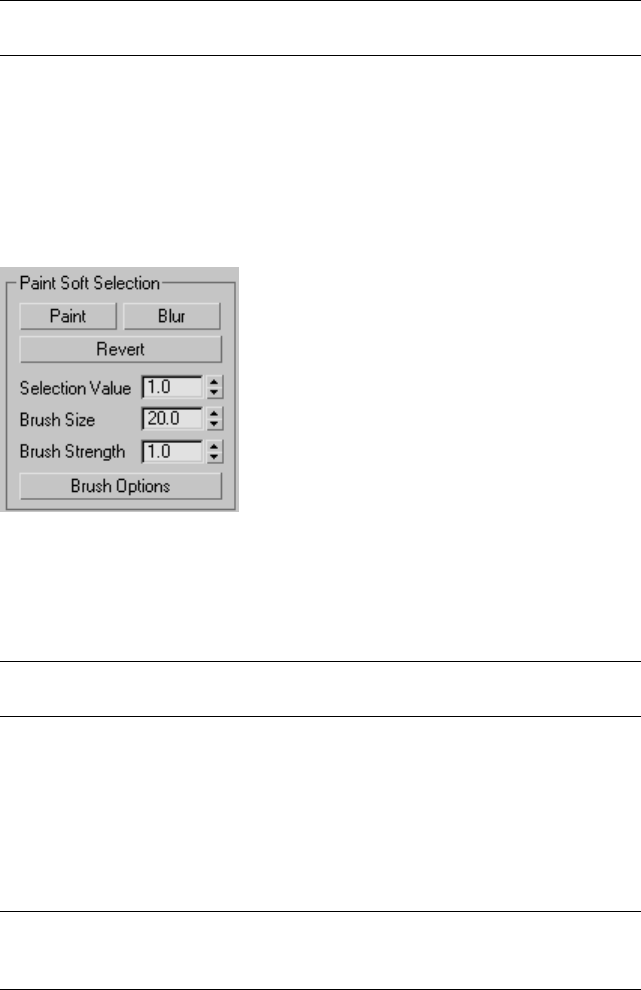
NOTE Use the Undo command if you do not want to change your vertex color
shading properties.
Lock Soft Selection Locks the soft selection in order to prevent changes to
the procedural selection.
Using Paint Soft Selection (see following) turns on Lock Soft Selection
automatically. If you turn it off after using Paint Soft Selection, the painted
soft selection is lost. You can restore it with Undo.
Paint Soft Selection group
Paint Soft Selection lets you specify a soft selection explicitly by dragging the
mouse over the selection. The Paint Soft Selection functionality is available
at sub-object levels with Editable Poly objects, as well as with objects with the
Edit Poly or Poly Select modifier applied. You can work in one of three painting
modes: Paint, Revert, and Blur.
TIP You can streamline the painting process by using the Brush Presets tools on
page 7293 .
Paint Lets you paint a soft selection on the active object using the current
settings. Drag the mouse cursor over the object surface to paint the selection.
Blur Lets you paint to soften the outlines of an existing painted soft selection.
Revert Lets you paint to reverse a soft selection on the active object using
the current settings. Drag the mouse cursor over the object surface to reverse
the selection.
NOTE Revert affects only a painted soft selection, not a soft selection made by
normal means. Also, Revert uses only the Brush Size and Brush Strength settings,
not the Selection Value setting.
1930 | Chapter 10 Surface Modeling

Selection Value The maximum relative selection of the painted or reverted
soft selection. The values of surrounding vertices within the brush radius fall
off towards a value of 0. Default=1.0.
Brush Size The radius of the circular brush used for painting the selection.
Brush Strength The rate at which painting a soft selection sets the painted
sub-objects to the maximum value. A high Strength value reaches the full
value quickly, while a low value requires repeated applications to reach full
value.
Brush Options Opens the Painter Options dialog on page 1907 , with settings
for brush-related properties.
Collapse Utility
Utilities panel > Utilities rollout > Collapse button
Menu bar > Modify > Collapse
The Collapse utility lets you combine the stack operations of one or more
selected objects into an Editable Mesh on page 1990 or the stack result, and,
optionally, perform a Boolean on page 686 operation on them at the same
time.
IMPORTANT You can't undo the results of using the Collapse utility. Before you
use it, save a copy of your work file, or use Hold on page 204 .
NOTE You can also collapse an object's stack from the modifier stack right-click
menu on page 7440 , and convert a selection to editable surfaces on page 1925 with
the transform quadrant of the quad menu on page 7300 . These changes are
undoable.
Procedures
To collapse the stack of an object into an editable mesh:
1On the Utilities panel, click the Collapse button.
2Select the object or objects that you want to collapse.
3Click the Collapse Selected button.
All modifiers are removed from the modifier stack and the object becomes
an editable mesh.
Collapse Utility | 1931
To collapse the stack of an object into an editable surface other than mesh:
1On the Utilities panel, click the Collapse button.
2On the Collapse rollout, set Output Type to Modifier Stack Result.
3Select the object or objects that you want to collapse.
4Apply a modifier that outputs the desired ultimate surface type, such as
Turn To Poly on page 1761 or Turn To Patch on page 1758 .
5Click the Collapse Selected button.
All modifiers are removed from the modifier stack and the object becomes
an editable surface of the type indicated by the modifier.
To subtract multiple objects from another object:
The Boolean compound object restricts you to combining objects one at a
time. With the Collapse utility, you can perform Boolean operations on several
objects simultaneously.
1For the purposes of this procedure, we'll call the object to have shapes
subtracted from Main. Create and arrange Main and the objects to subtract
from it. For example, you might have several boxes penetrating a sphere
(Main) in different places; subtracting them will produce box-shaped
cutouts in the sphere's surface.
2Select Main, and then select the objects to be subtracted from it.
The first object you select before collapsing is the one from which the
others are subtracted.
3On the Utilities panel, click the Collapse button.
4On the Collapse rollout, set Output Type to Mesh, if necessary.
5In the Collapse To group, choose Single Object.
6Turn on Boolean, and then choose Subtraction.
7Click the Collapse Selected button.
All objects you selected after Main, the first object, are subtracted from
Main.
1932 | Chapter 10 Surface Modeling
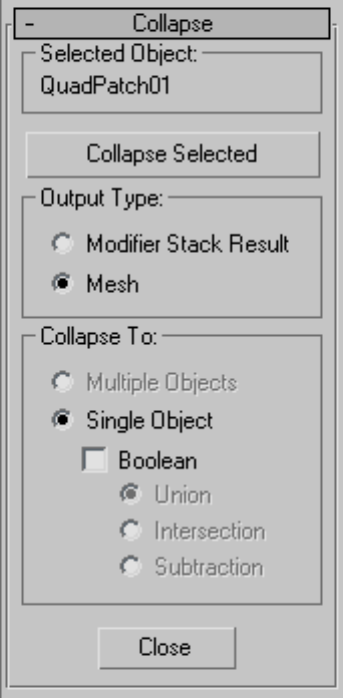
Interface
Selected Object group
Displays the name of the current selection. If more than one object is selected,
"[Number] Objects Selected.” displays.
Collapse Selected Collapses the selected objects. The method of collapse
depends on the settings of the options below this button.
Output Type group
Specifies the type of object that results from the collapse.
Collapse Utility | 1933
Modifier Stack Result The resultant object will be the same as if you had
collapsed its stack. In most cases, this results in a mesh object, as when using
the Mesh option. However, if the object has an Edit Patch modifier so that its
stack produces a patch, then the result will be a patch object rather than a
mesh. Likewise, a shape with Edit Spline modifiers becomes an editable spline.
When this option is used, the Collapse To options are unavailable, and all
selected objects remain independent objects.
Mesh All selected objects become editable meshes regardless of their type
before they were collapsed.
Collapse To group
Specifies how the selected objects are combined. These options are available
only when you choose the Mesh option.
Multiple Objects Collapses each object in the selection but maintains each
as an independent object. When this option is selected, the Boolean options
are disabled.
Single Object Collapses all selected objects into a single, editable mesh object.
Boolean Performs Boolean operations on the selected objects. During the
Boolean calculation, a progress bar appears along with a Cancel button. If any
objects in the Boolean operation fail, that object is skipped, but the Collapse
proceeds. The result is not a Boolean compound object, but a single editable
mesh. The type of Boolean is specified by the following option.
Union Combines the several objects, removing intersecting geometry.
Intersection Removes all but the intersecting geometry.
Subtraction Maintains the first object selected while subtracting the
subsequently selected objects. For example, to subtract several cylinders from
a box, click to select the box, hold down Ctrl, and region-select the cylinders.
Close Exits the Collapse utility.
Editable Patch Surface
Create or select an object > Modify panel > Right-click object's entry in the
stack display > Convert To: Editable Patch
Create or select an object > Right-click the object > Transform (lower-right)
quadrant of the quad menu > Convert To: > Convert to Editable Patch
1934 | Chapter 10 Surface Modeling

Editable Patch provides controls for manipulating an object as a patch object
and at five sub-object levels: vertex, handle, edge, patch, and element.
Editable Patch objects provide the same basic functionality as the Edit Patch
modifier on page 1290 . Because working with them requires less processing and
memory, we recommend you use Editable Patch objects rather than the Edit
Patch modifier whenever possible.
When you convert an object to Editable Patch format or apply an Edit Patch
modifier, 3ds Max converts the object's geometry into a collection of separate
Bezier patches on page 7888 , each patch made up of a framework of vertices
and edges, plus a surface.
■The framework of control points and connecting tangents defines the
surface. Transforming the components of this framework is the primary
technique in patch modeling. The framework does not appear in scanline
renderings.
■The surface is the Bezier patch surface, whose shape is controlled by the
vertices and edges. The surface is the renderable geometry of the object.
Prior to version 3 of the software, some patch objects contained a lattice that
appeared separate from the surface. This is no longer the case: The control
framework conforms exactly to the surface, making it easier to visualize the
results of patch modeling.
The output of the Surface modifier on page 1695 is a patch surface. If you are
modeling with splines and are using the Surface modifier to generate a patch
surface from the spline cage, you can use an Edit Patch modifier on page 1290
for further modeling.
Show End Result
Turn on Show End Result on the Modify panel if you have modifiers
above the Editable Patch modifier and want to see the result of all the modifiers
in the modifier stack. This function will remain on until you turn it off.
See also:
■Edit Modifiers and Editable Objects on page 1027
■Modifying at the Sub-Object Level on page 1029
■Modifier Stack Controls on page 7427
Editable Patch Surface | 1935
Procedures
To work at a sub-object level:
1In the modifier stack display, choose a selection level: Element, Patch,
Edge, or Vertex.
2Select the sub-object geometry you want to edit.
To attach an object using Edit Patch:
1Select an editable patch object, or an object with the Edit Patch modifier
applied.
2In the Modify panel > Geometry rollout > Topology group, click Attach.
3Turn off Reorient, if necessary.
4Select an object to attach.
The object takes on a patch structure and stays in its original location.
The attached object is now part of the editable patch object. The
Tessellation settings for the original object affect attached objects as well.
To attach and reorient an object:
■Turn on Reorient before attaching the object.
The object is both attached and moved to align with the patch object. The
pivot of the attached object matches the pivot of the Edit Patch object.
To detach a patch surface:
1Make a selection at the Patch sub-object level.
2If you want to reorient the detached surface, turn on Reorient.
3Click Detach.
A Detach dialog appears.
4Name the detached surface.
The detached surface remains in place if you chose not to reorient it. It
is deselected and assigned a different color.
To copy a patch surface:
1Make a selection at the Patch sub-object level.
1936 | Chapter 10 Surface Modeling
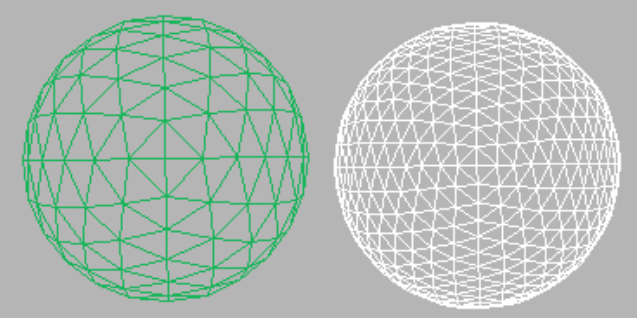
2In the Geometry rollout > Topology group, turn on Copy.
3If you want to reorient the copied surface, turn on Reorient.
4Click Detach.
A Detach dialog appears.
5Name the patch copy.
The copied object remains in place if you chose not to reorient it.
To delete patches:
1Make a selection at the Patch sub-object level.
2Click Delete.
The patches disappear.
To subdivide a patch:
1Make a selection at the Patch sub-object level.
2Turn on Propagate to maintain surface continuity.
3Click Subdivide.
The patch selection is subdivided, increasing the number of patches.
You can repeat this process, subdividing multiple times. Each subdivision
increases the number of patches, which become increasingly smaller. The
following figure is an example of modeling a highly subdivided surface.
Editable Patch Surface | 1937
To subdivide an edge:
1At the Edge sub-object level, make an edge selection.
A single edge is indicated by its coordinate axis or transform gizmo at
the center of the edge. For multiple edges, the axis icon is at the center
of the selection set.
2Optionally, turn on Propagate to maintain surface continuity.
3Click Subdivide.
The edge selection is subdivided. Each new edge is on the boundary of a
new, smaller patch.
To add a patch:
1At the Edge sub-object level, select an open edge (one that bounds a single
patch, and therefore is not shared with another patch).
2Click Add Tri or Add Quad.
A new patch is added to the surface.
To unlock interior edges of selected patches:
1At the Patch sub-object level, select one or more patches.
2Right-click the selection and choose Manual Interior from the pop-up
menu.
The check mark moves from Auto Interior, the default, to Manual Interior.
Interior edges and their vertices are now unlocked. If you now transform
the patch, the interior edges remain static. To transform the interior
vertices, see the following procedure.
To transform interior vertices:
1At the Patch sub-object level, select one or more patches.
2Right-click the selection and choose Manual Interior from the pop-up
menu.
The check mark moves from Auto Interior, the default, to Manual Interior.
3Switch to Handle level.
The interior vertices appear as yellow squares.
4Transform the interior vertices of the selected patches.
1938 | Chapter 10 Surface Modeling
To anchor a patch:
By default, the welding process shifts the geometry of both patches to a
common center. You can anchor one patch so that the other patch moves to
its location when the weld occurs.
1At the Patch (Patch) level, before you begin the weld, select the patch
you want anchored.
2Return to Vertex level and weld the vertices.
When the weld occurs, the anchor patch remains fixed while the other
patch moves to make the weld.
To create a new element, do one of the following:
1Shift+drag one or more patches.
2Shift+extrude one or more patches.
3Shift+extrude one or more edges.
4Shift+drag an element.
Interface
Selection rollout
For information about these settings, see Selection Rollout (Editable Patch)
on page 1940 .
Soft Selection rollout
For information on the Soft Selection rollout settings, see Soft Selection Rollout
on page 1926 .
Geometry and Surface Properties rollouts
The Geometry rollout on page 1968 provides functions for editing a patch
object and its sub-objects, and the Surface Properties controls let you modify
the object's rendering characteristics. For detailed information on
sub-object-specific controls, select any of the links below:
Editable Patch (Object) on page 1944
Editable Patch (Vertex) on page 1947
Editable Patch (Handle) on page 1954
Editable Patch Surface | 1939
Editable Patch (Edge) on page 1956
Editable Patch (Patch) on page 1959
Selection Rollout (Editable Patch)
Create or select an object > Modify panel > Right-click object's entry in the
stack display > Convert To: Editable Patch > Selection rollout
Create or select an object > Right-click the object > Transform (lower-right)
quadrant of the quad menu > Convert To: > Convert to Editable Patch >
Selection rollout
The Selection rollout provides buttons for selecting the sub-object level,
working with named selections, display and filter settings, and displays
information about selected entities.
Editable Patch has five levels of sub-object editing: Vertex, Handle, Edge, Patch,
and Element. The selection you make at each level appears in the viewport as
a component of the patch object. Each level maintains its own sub-object
selection. When you return to a level, the selection reappears.
Clicking a sub-object level button here is the same as clicking a sub-object
type in the Modifier Stack rollout. Click the button again to turn it off and
return to the object selection level.
1940 | Chapter 10 Surface Modeling
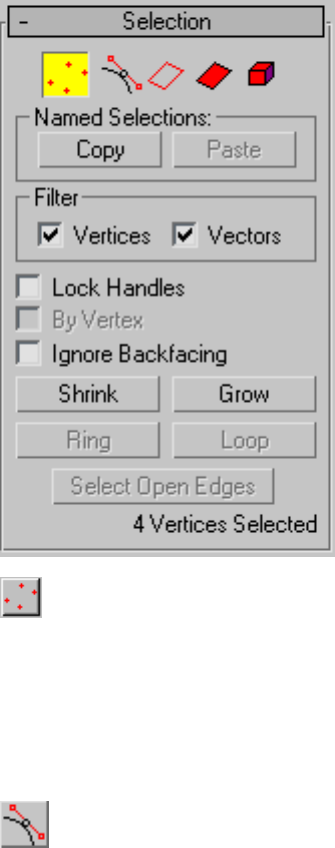
Interface
Vertex Lets you select vertex control points and their vector handles
on a patch object. At this level, vertices can be welded and deleted.
By default, a transform gizmo or axis tripod appears at the geometric center
of the selected vertices. If you turn on Gizmo Preferences on page 7570 > Allow
Multiple Gizmos, however, gizmos or tripods appear at all selected vertices.
Vector handles appear as small green squares around selected vertices. Also,
with certain objects you may see interior vertices represented as yellow squares.
Handle Lets you select vector handles associated with each vertex.
This level lets you manipulate the handles without needing to deal with
vertices.
A Transform gizmo or axis tripod appears at the geometric center of the selected
handles.
Selection Rollout (Editable Patch) | 1941
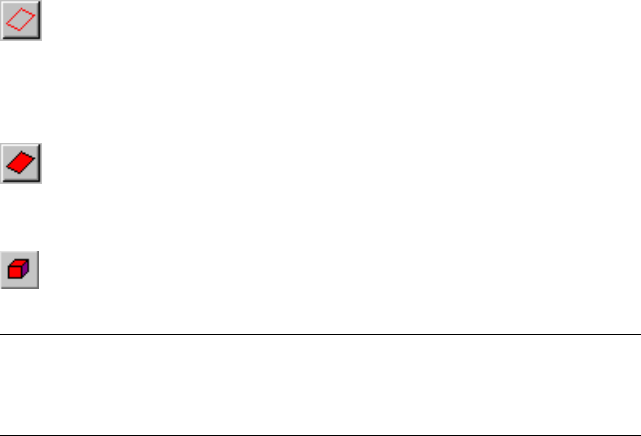
At this level, vector handles appear as small green squares around all vertices.
Also, with certain objects you may see interior vertices represented as yellow
squares.
Edge Selects a bounding edge of the patch object. At this level, edges
can be subdivided, and new patches added to open edges.
A Transform gizmo or axis tripod appears in the middle of a single selected
edge. For multiple selected edges, the icon is at the selection center.
Patch Selects an entire patch. At this level, a patch can be detached,
deleted, or its surface subdivided. When a patch is subdivided, the surface is
broken into smaller patches, each with its own vertices and edges.
Element Select and edit an entire element. An element has contiguous
faces.
TIP You can highlight selected patches in a shaded display by turning on Shade
Selected Faces in the Viewport Properties dialog. Right-click over the viewport
name and choose Configure in the menu to display the Viewport Properties dialog.
You can also use the default keyboard shortcut, F2 , to toggle this feature.
Named Selections group
These functions work with named sub-object selection sets. To create a named
sub-object selection, make the selection, and then enter a name in the Named
Selection Sets field on the toolbar. For more information, see Named Selection
Sets on page 179 .
Copy Places a named sub-object selection into the copy buffer. After clicking
this button, choose the named sub-object selection from the Copy Named
Selection dialog that appears.
Paste Pastes the named sub-object selection from the copy buffer.
You can use Copy and Paste to copy sub-object selections between different
objects.
Filter group
These two check boxes, available only at the Vertex sub-object level, let you
select and transform vertices, vectors (handles on the vertices), or both. When
a check box is turned off, you can't select the corresponding element type.
1942 | Chapter 10 Surface Modeling
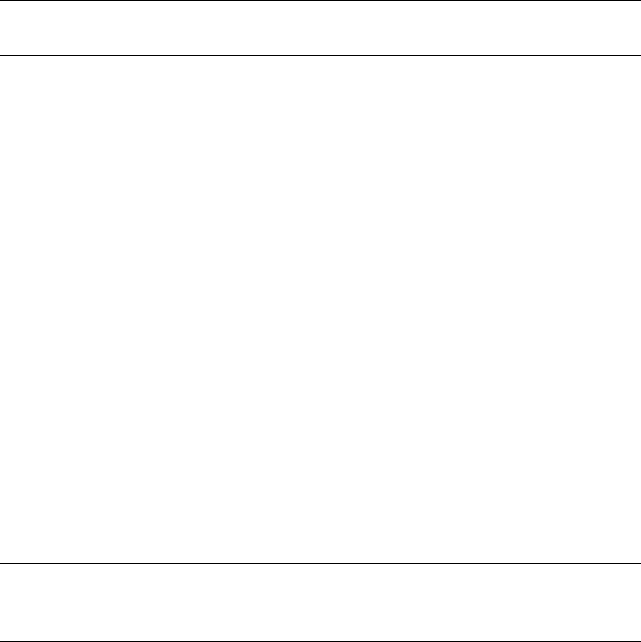
Thus, for example, if you turn off Vertices, you can manipulate vectors without
accidentally moving a vertex.
TIP For easier editing of vectors only, use the Handle sub-object level on page
1954 .
You can't turn off both check boxes. When you turn off either check box, the
other one becomes unavailable. At that point, you can manipulate the element
corresponding to the check box that's on, but you can't turn it off.
Vertices When on, you can select and move vertices.
Vectors When on, you can select and move vectors.
Lock Handles Affects only Corner vertices. Locks the tangent vectors together
so that when you move one, you move them all. Available only at the Vertex
sub-object level.
By Vertex When you click a vertex, any handles, edges, or patches that use
that vertex, depending on the current sub-object level, are selected. Available
only at the Handle, Edge, and Patch sub-object levels.
This also works with Region Select.
Ignore Backfacing When on, selection of sub-objects selects only those
sub-objects whose normals are visible in the viewport. When off (the default),
selection includes all sub-objects, regardless of the direction of their normals.
Use this on a complex patch model where you want to select only visible
patches.
NOTE The state of the Backface Cull setting in the Display panel does not affect
sub-object selection. Thus, if Ignore Backfacing is off, you can still select sub-objects,
even if you can't see them.
Shrink Reduces the sub-object selection area by deselecting the outermost
sub-objects. If the selection size can no longer be reduced, the remaining
sub-objects are deselected. Unavailable at the Handle sub-object level.
Grow Expands the selection area outward in all available directions.
Unavailable at the Handle sub-object level.
Ring Expands an edge selection by selecting all edges parallel to the selected
edges. Available only at the Edge sub-object level.
Loop Expands the selection as far as possible, in alignment with selected
edges. Available only at the Edge sub-object level.
Selection Rollout (Editable Patch) | 1943
Select Open Edges Selects all edges that are used by only one patch. Available
only at the Edge sub-object level.
You can use this to troubleshoot a surface; open edges will be highlighted.
Selection Information At the bottom of the Selection rollout is a text display
giving information about the current selection. If multiple sub-objects are
selected, or none is selected, the text gives the number and type selected. If
one sub-object is selected, the text gives the identification number and type
of the selected item.
Editable Patch (Object)
Select an editable patch > Modify panel > Editable patch (not a sub-object
level) selected in the modifier stack
Select an editable patch > Right-click the patch > Tools 1 (upper-left) quadrant
of the quad menu > Sub-objects > Top-level
The functions available at the editable patch object level (that is, when no
sub-object level is chosen) are also available at all sub-object levels, and work
exactly the same at each level.
Interface
Selection rollout
For information on these settings, see Editable Patch Surface on page 1934 .
1944 | Chapter 10 Surface Modeling

Geometry rollout
Editable Patch (Object) | 1945
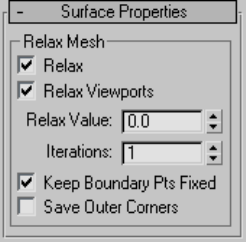
See Geometry Rollout (Patch) on page 1968 for detailed descriptions of these
controls.
Surface Properties rollout
The Relax Mesh controls on the Surface Properties rollout change the apparent
surface tension by moving vertices closer to, or away from, their neighbors.
The typical result is that the object gets smoother and a little smaller as the
vertices move toward an averaged center point. You can see the most
pronounced effects on objects with sharp corners and edges.
Relax Turns on the relax function for renderings.
Relax Viewports Turns on the relax function for viewports.
Relax Value Sets the distance a vertex moves as a percentage of the distance
between a vertex and the average location of its neighbors. Range=-1.0 to 1.0.
Default=0.5.
Iterations Sets how many times Relax is repeated. Each iteration recalculates
average vertex locations based on the result of the previous iteration. Default=1.
Keep Boundary Points Fixed Vertices at the edge of open patches do not
relax. Default=on.
Save Outer Corners Preserves the original positions of vertices farthest away
from the object center.
1946 | Chapter 10 Surface Modeling
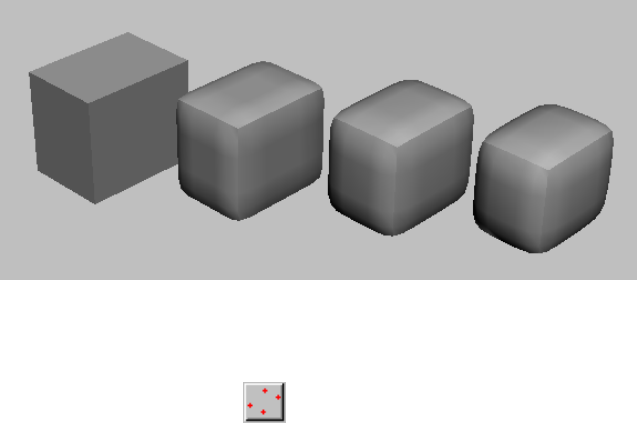
A patch box with Relax off (left), and Relax Value=1.0, with 1, 2, and 3 iterations (left
to right)
Editable Patch (Vertex)
Select an editable patch > Modify panel > Expand Editable Patch in the stack
display > Vertex sub-object level
Select an editable patch > Modify panel > Selection rollout > Vertex button
Select an editable patch > Right-click the patch > Tools 1 (upper-left) quadrant
of the quad menu > Sub-objects > Vertex
At the Editable Patch (Vertex) level, you can select single and multiple vertices
and move them using standard methods. You can also move and rotate vector
handles on page 7964 , thus affecting the shapes of any patches connected to
the vertex.
Procedures
To transform either vertices or vectors:
1At Patch (Vertex) level, with Selection rollout > Filter group > Vertices
turned on, select vertices in the patch object you want to transform.
Vertices and their vectors both appear.
2Turn off one of the filters, leaving the other on, and choose a transform.
A transform cursor appears when you move onto a vertex or vector in
the selection set. You can toggle between filters to alternatively transform
either component.
Editable Patch (Vertex) | 1947
To switch vertex types:
1Right-click a patch vertex.
2Choose from commands on the quad menu. The Tools 1 (upper-left)
quadrant includes two options specific to patch vertices:
■Coplanar: If you set a patch control point's property to be coplanar,
it's like locking the handle of the outgoing vector for that point.
Moving a handle attached to a coplanar vertex causes the opposite
vectors to adjust their positions to maintain a coplanar surface. This
option is the default and gives smooth transitions between patches.
■Corner: If you set a patch control point's property to be corner, it
unlocks the handle of the outgoing vector, so you can create a
discontinuous break in the patch surface.
To switch vertex types from Coplanar to Corner, do one of the following:
1Hold down Shift as you move a handle of a Coplanar vertex.
This switches the vertex type to Corner.
If Lock Handles is off (the default), Shift+Move "breaks" the handle,
allowing it to move independently.
If Lock Handles is on, the handles remain locked in their coplanar
relationship. However, the vertex is still switched to Corner, and turning
off Lock Handles lets you move the handles separately.
2Right-click the vertex, and choose Corner from the quad menu.
To delete a vertex:
1At Patch (Vertex) level, select a vertex.
2Click Delete.
The vertex and all patches sharing this control point are deleted.
1948 | Chapter 10 Surface Modeling
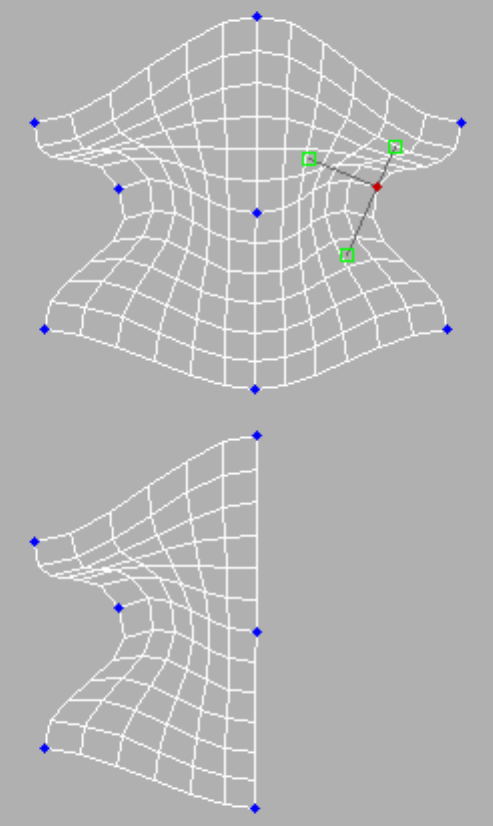
Deleting vertices
To weld vertices:
1At Patch (Vertex) level, select two valid vertices on different patches.
Editable Patch (Vertex) | 1949
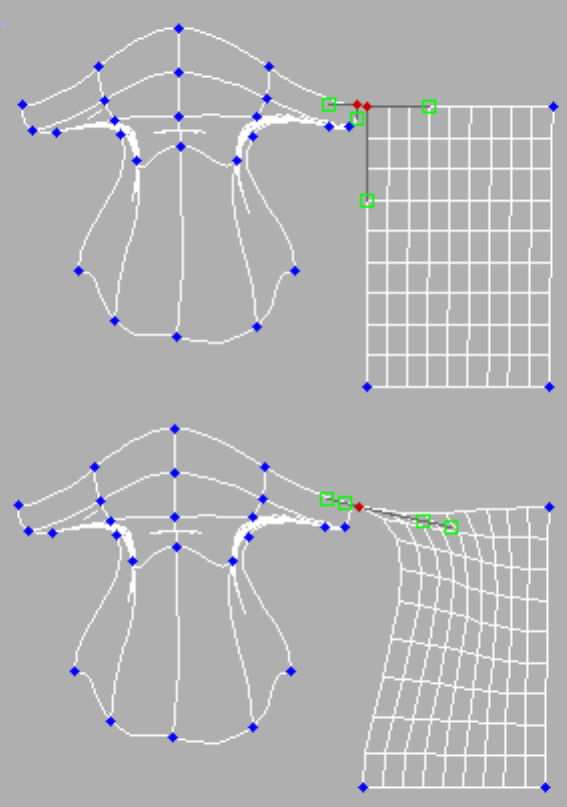
2Set Weld Threshold to a value at least equal to the distance between the
selected vertices.
3Click Selected.
The two vertices move together and join.
Welding vertices
1950 | Chapter 10 Surface Modeling

To transform interior vertices:
Using program defaults, you can select only vertices and vectors on the outer
edge or boundary of a patch. This default is known as Auto Interior.
In some cases, you might want to move the interior vertices. For example,
you might want to tweak a patch's curvature without having to subdivide the
patch.
■At Patch level on page 1959 , you can change the default on a patch-by-patch
basis by right-clicking a patch and choosing Manual Interior from the
shortcut menu. This lets you select and transform individual interior
vertices. These vertices appear as yellow squares in the viewports.
WARNING If you return a patch to the default, changes due to Manual Interior
are lost.
NOTE Certain objects are automatically set to Manual Interior when converted
to patch objects. In such cases, you can see all interior vertices when you go
to the Vertex sub-object level.
Interface
Selection rollout
For information on the controls in this rollout, see Selection Rollout (Editable
Patch) on page 1940 .
Soft Selection rollout
See Soft Selection Rollout on page 1926 for information on the Soft Selection
rollout settings.
Editable Patch (Vertex) | 1951

Geometry rollout
1952 | Chapter 10 Surface Modeling
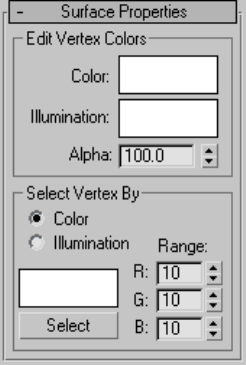
See Geometry Rollout (Patch) on page 1968 for detailed descriptions of these
controls.
Surface Properties rollout
Edit Vertex Colors group
Use these controls to assign the color, illumination color (shading), and alpha
(transparency) values of selected vertices.
Color Click the color swatch to change the color of selected vertices.
Illumination Click the color swatch to change the illumination color of
selected vertices. This lets you change the color of shadows without changing
the vertex colors.
Alpha Lets you assign an alpha (transparency) value to selected vertices.
The spinner value is a percentage; zero is completely transparent and 100 is
completely opaque.
Select Vertex By group
Color and Illumination radio buttons These buttons determine whether to
select vertices by vertex color values or vertex illumination values.
Color Swatch Displays the Color Selector, where you can specify a color to
match.
Editable Patch (Vertex) | 1953

Select Depending on which radio button is selected, selects all vertices whose
vertex color or illumination values either match the color swatch, or are within
the range specified by the RGB spinners.
Range Specifies a range for the color match. All three RGB values in the
vertex color or illumination must either match the color specified by the Color
swatch in Select By Vertex Color, or be within plus or minus the values in the
Range spinners. Default=10.
Editable Patch (Handle)
Select an editable patch > Modify panel > Expand the editable patch in the
stack display > Handle sub-object level
Select an editable patch > Modify panel > Selection rollout > Handle button
Select an editable patch > Right-click the patch > Tools 1 (upper-left) quadrant
of the quad menu > Sub-objects > Handle
The Handle sub-object level in Editable Patch provides direct access to vertex
handles, or vectors, without going through the Vertex sub-object level. Handles
are still accessible at the Vertex sub-object level, but the Handle level provides
enhanced functionality as follows:
■The ability to select multiple handles for transformation and application
of operations such as Patch Smooth to them.
■Usage of the transform gizmo when manipulating handles.
■Elimination of the possibility of inadvertently transforming vertices.
■Support for named selection sets of handles.
■Copying and pasting handles.
■Use the Align tool on page 938 for aligning handles.
1954 | Chapter 10 Surface Modeling

Interface
Editable Patch (Handle) | 1955
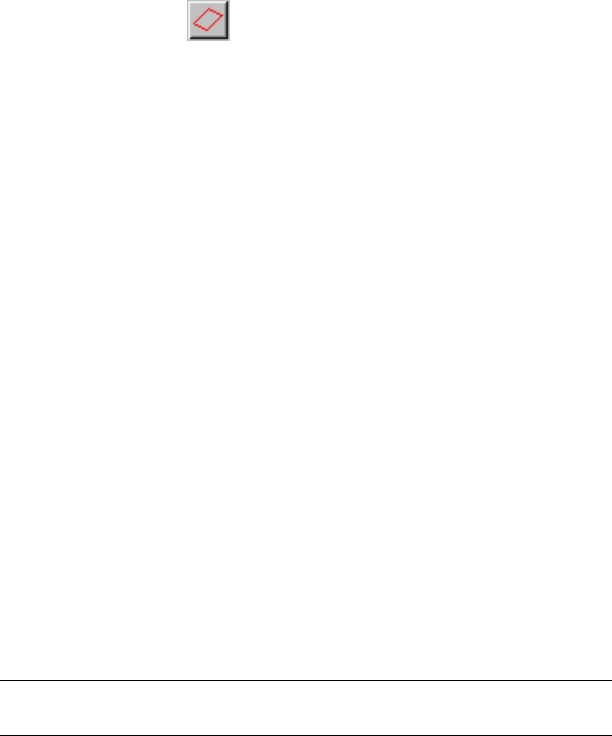
See Geometry Rollout (Patch) on page 1968 for detailed descriptions of these
controls.
Editable Patch (Edge)
Select an editable patch > Modify panel > Expand the editable patch in the
stack display > Edge sub-object level
Select an editable patch > Modify panel > Selection rollout > Edge button
Select an editable patch > Right-click the patch > Tools 1 (upper-left) quadrant
of the quad menu > Sub-objects > Edge
An edge is the portion of a patch object between two adjacent vertices. When
at the Editable Patch (Edge) level, you can select single and multiple segments
and move, rotate, and scale them using standard methods. You can also hold
down the Shift key and drag an edge to create a new patch. Holding down the
Shift key during edge extrusion creates a new element.
Procedures
To unlock interior edges:
When you move an outer or boundary edge of a patch, the adjacent interior
edges are normally “locked” so that they move in parallel with the boundary
edge. This is often useful, because it provides a uniform transition across the
patch. This default is known as Auto Interior.
■At Patch level on page 1959 , you can change the default on a patch-by-patch
basis by right-clicking a patch and choosing Manual Interior from the
Tools 1 (upper-left) quadrant of the quad menu. Thereafter, when you
move a boundary edge, interior edges are affected in a nonlinear way. The
interior edges are no longer locked to the boundary edge.
WARNING If you return a patch to the default, changes caused by Manual
Interior are lost.
1956 | Chapter 10 Surface Modeling
Interface
Selection rollout
Select Open Edges Selects all edges that are used by only one patch. You
can use this to troubleshoot a surface; open edges will be highlighted.
For information on the other controls in this rollout, see Selection Rollout
(Editable Patch) on page 1940 .
Soft Selection rollout
See Soft Selection Rollout on page 1926 for information on the Soft Selection
rollout settings.
Editable Patch (Edge) | 1957

Geometry rollout
1958 | Chapter 10 Surface Modeling

See Geometry Rollout (Patch) on page 1968 for detailed descriptions of these
controls.
Editable Patch (Patch)
Select an editable patch > Modify panel > Expand the editable patch in the
stack display > Patch sub-object level
Select an editable patch > Modify panel > Selection rollout > Patch button
Select an editable patch > Right-click the patch > Tools 1 (upper-left) quadrant
of the quad menu > Sub-objects > Patch
A patch is an area of a patch object, defined by three or four surrounding
edges and vertices. Controls described in this topic let you manipulate a patch
object at the patch level. As well as moving and rotating patches, you can
create a separate element by holding down the Shift key during a move
operation. This creates a separate element of the selected patches.
Texture Mapping Patches: Interpolation in Curved Space
Patches can now be mapped in curved space; this means simplified texture
mapping for patches. A planar map on a complex patch object will not be
distorted. At the Patch sub-object level there is a parameter in the right-click
quad menu (Tools 1 quadrant) called Linear Mapping. If you leave Linear
Mapping off, then textures are interpolated in curved space and behave much
like texture mapping a mesh object, predictably.
In the old method, patch mapping is interpolated between the knot points.
This works well with procedural maps but not so well with bitmaps, since
each patch is linear in UV space.
Editable Patch (Patch) | 1959
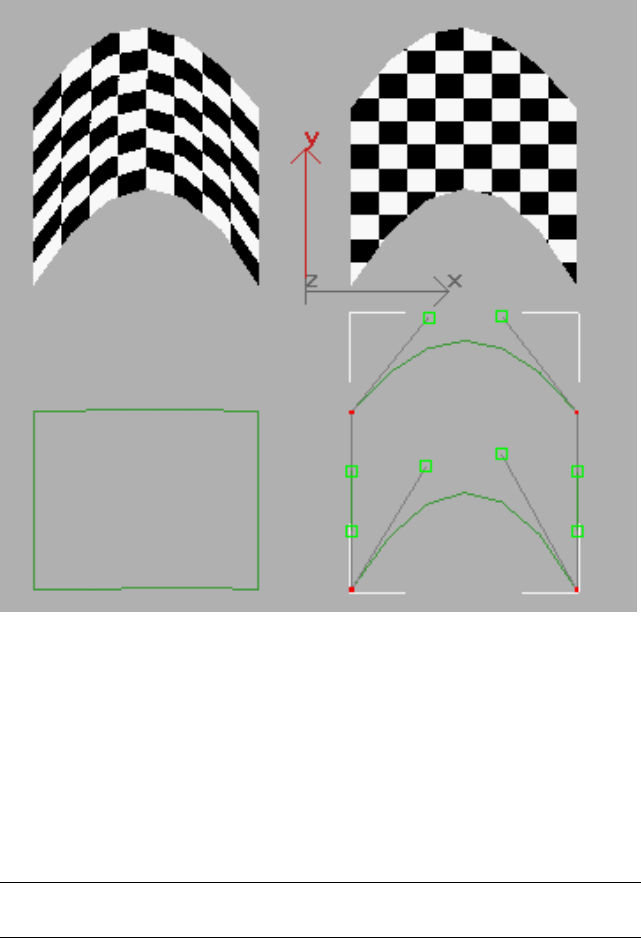
A complex patch (on right) no longer deforms a bitmap
The two leftmost patches show Linear patch mapping. The top left patch is a
patch with planar mapping and the bottom left shows its UVW space
representation. The patch on the right is a curved projection where the vectors
are used in UVW space projection. Notice the bottom right represents the
UVW space and notice how the handles and knots contribute to the shape of
the UVW space.
In short, leave the Linear option off for predictable planar maps. Leave the
linear mapping option on for backward compatibility.
NOTE The Unwrap UVW modifier now supports the new patch curve mapping.
Spline handles can be manipulated in the Edit dialog in the Unwrap UVW modifier.
1960 | Chapter 10 Surface Modeling
Interface
Selection rollout
For information on the controls in this rollout, see Selection Rollout (Editable
Patch) on page 1940 .
Soft Selection rollout
See Soft Selection Rollout on page 1926 for information on the Soft Selection
rollout settings.
Editable Patch (Patch) | 1961

Geometry rollout
1962 | Chapter 10 Surface Modeling
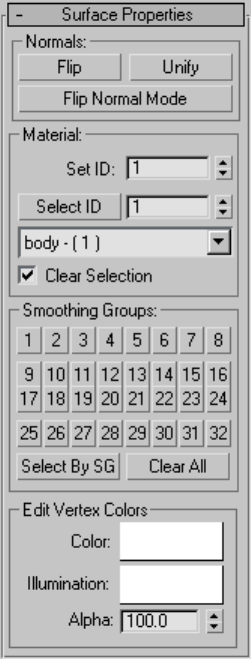
See Geometry Rollout (Patch) on page 1968 for detailed descriptions of these
controls.
Surface Properties rollout
These controls let you work with patch normals, material IDs, smoothing
groups and vertex colors.
Normals group
Flip Reverses the direction of the surface normals of the selected patches.
Editable Patch (Patch) | 1963
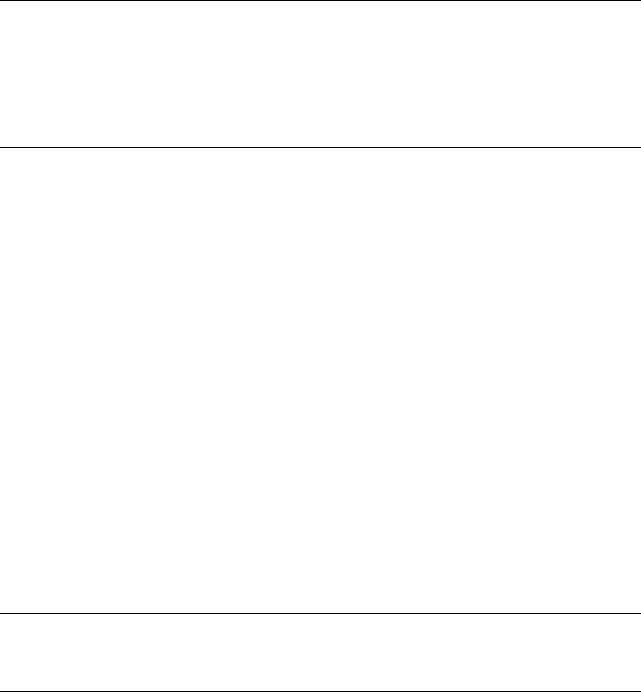
Unify Flips the normals of an object so that they all point in the same
direction, usually outward. This is useful for setting an object's patches to
appropriate orientations, thus eliminating apparent holes in the object surface.
Flip Normal Mode Flips the normal of any patch you click. To exit, click this
button again or right-click anywhere in the program interface.
TIP The best way to use Flip Normal Mode is to set up your viewport to display
with Smooth+Highlight and Edged Faces on. If you use Flip Normal Mode with
default settings, you'll be able to flip a patch away from you, but you won't be
able to flip it back. For best results, turn off Ignore Backfacing in the Selection
rollout. This lets you click any patch and flip the direction of its normal, regardless
of its current direction.
Material group
These controls let you use multi/sub-object materials on page 5558 with patches.
Set ID Lets you assign a particular material ID on page 7842 number to selected
patches for use with multi/sub-object materials and other applications. Use
the spinner or enter the number from the keyboard. The total number of
available IDs is 65,535.
Select ID Selects patches or elements corresponding to the Material ID
specified in the adjacent ID field. Type or use the spinner to specify an ID,
then click the Select ID button.
[Select By Name] This drop-down list shows the names of sub-materials if
an object has a Multi/Sub-Object material assigned to it. Click the drop arrow
and choose a sub-material from the list. The patches or elements that are
assigned that material are selected. If an object does not have a
Multi/Sub-Object material assigned, the name list is unavailable. Likewise, if
multiple objects are selected that have an Edit Patch, Edit Spline, or Edit Mesh
modifier applied, the name list is inactive.
NOTE Sub-material names are those specified in the Name column on the
material's Multi/Sub-Object Basic Parameters rollout; these are not created by
default, and must be specified separately from any material names.
Clear Selection When on, choosing a new ID or material name deselects any
previously selected patches or elements. When off, selections are cumulative,
so new ID or sub-material name selections add to the existing selection set of
patches or elements. Default=on.
1964 | Chapter 10 Surface Modeling

Smoothing Groups group
Use these controls to assign selected patches to different smoothing groups
on page 7932 , and to select patches by smoothing group.
To assign patches to one or more smoothing groups, select the patches, and
then click the number(s) of the smoothing group(s) to assign them to.
Select by SG (Smoothing Group) Displays a dialog that shows the current
smoothing groups. Select a group by clicking the corresponding numbered
button and clicking OK.
Clear All Removes any smoothing group assignments from selected patches.
Edit Vertex Colors group
Use these controls to assign the color, illumination color (shading), and alpha
(transparency) values of vertices on the selected patch(es).
Color Click the color swatch to change the color of vertices on the selected
patch(es).
Illumination Click the color swatch to change the illumination color of
vertices on the selected patch(es). This lets you change the color of shadows
without changing the vertex colors.
Alpha Lets you assign an alpha (transparency) value to vertices on the selected
patch(es).
The spinner value is a percentage; zero is completely transparent and 100 is
completely opaque.
Editable Patch (Element)
Select an editable patch > Modify panel > Expand the editable patch in the
stack display > Element sub-object level
Select an editable patch > Modify panel > Selection rollout > Element button
Select an editable patch > Right-click the patch > Tools 1 (upper-left) quadrant
of the quad menu > Sub-objects > Element
Use the Element sub-object level when you want to select and work on all
contiguous faces in an element. The Element sub-object level is essential when
you are Shift+cloning and Shift+extruding patches, because doing so creates
separate elements. For example, if you select a patch, hold down the Shift key,
Editable Patch (Element) | 1965

and move the patch to a new location, a new element is created separate from
the original. This also applies to extrusion. If you hold the Shift key down
while you extrude, a new element is created.
NOTE In some cases, you might find that moving a patch element causes parts
of it to move by differing amounts. This typically occurs because the object is set
to Manual Interior. It happens, for instance, when you convert a sphere primitive
to an editable patch object. To remedy this, select the element, and then right-click
it to display the quad menu, and in the Tools1 quadrant, choose Auto Interior.
Interface
Selection rollout
For information on the controls in this rollout, see Selection Rollout (Editable
Patch) on page 1940 .
Soft Selection rollout
See Soft Selection Rollout on page 1926 for information on the Soft Selection
rollout settings.
1966 | Chapter 10 Surface Modeling

Geometry rollout
Editable Patch (Element) | 1967
See Geometry Rollout (Patch) on page 1968 for detailed descriptions of these
controls.
Geometry Rollout (Patch)
Select an editable patch > Modify panel > Geometry rollout
The Geometry rollout for Patches contains most of the controls that let you
alter the geometry of the patch, at either the Object (top) level, or one of the
sub-object levels. The controls that the rollout displays can vary, depending
on which level is active; if a control is not available for the active level, it
might be grayed out, or simply might not appear at all. The descriptions below
indicate the levels at which controls are available.
1968 | Chapter 10 Surface Modeling

Interface
Geometry Rollout (Patch) | 1969
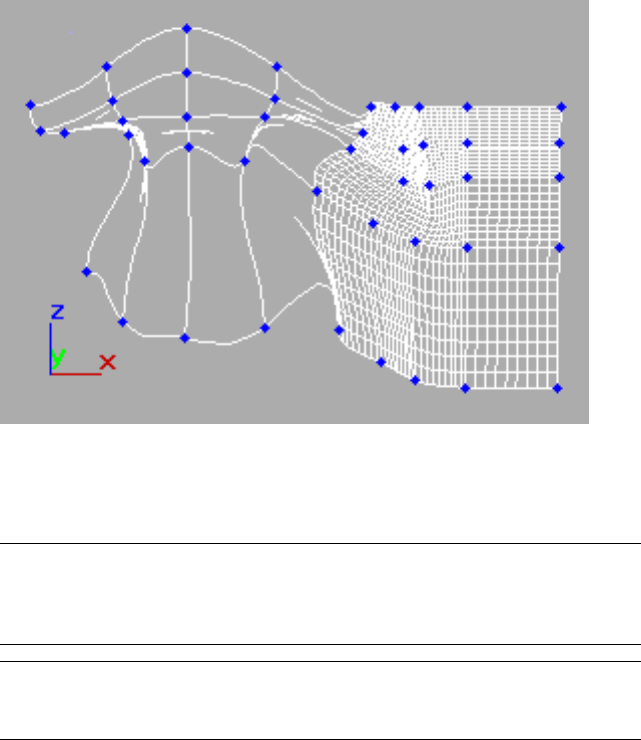
Subdivision group (Vertex, Edge, Patch, and Element levels only)
Bind (Vertex level only) Lets you create a seamless, gapless connection
between two patch edges that have unequal numbers of vertices. The two
patches must belong to the same object, and the vertex need not be selected
first. Click Bind, then drag a line from an edge-based vertex (not a corner
vertex) to the edge you want to bind it to. The cursor turns into a white cross
when over a legal edge.
Binding patch edges
To exit Bind mode, click the Bind button again, or right-click in the active
viewport.
TIP When connecting two patches edge-to-edge, first line up as many pairs of
vertices as possible, and use Weld to connect them. Then use Bind to connect the
remaining vertices. Bound vertices cannot be manipulated directly, although their
handles can.
NOTE Bind is useful for connecting patch objects with different patch resolutions,
such as a head and a neck, without the need to create additional patches in the
lower-resolution object.
Unbind (Vertex level only) Disconnects a vertex connected to a patch with
Bind. Select the vertex, and then click Unbind.
1970 | Chapter 10 Surface Modeling
Subdivide (Edge, Patch, and Element levels only) Subdivides the selected
sub-objects.
■Propagate When on, extends the subdivision to neighboring patches.
Propagating the subdivisions along all contiguous patches prevents patch
cracks where you have attached patches together.
Topology group
Add Tri / Add Quad (Edge level only) You can add Tri and Quad patches to
any open edge of an object. On closed objects such as spheres, you can delete
one or more existing patches to create open edges, and then add new patches.
The new patches adapt to the existing geometry. For example, when you add
a patch to a curved edge, the new patch follows that curve and seamlessly
extends it.
Geometry Rollout (Patch) | 1971
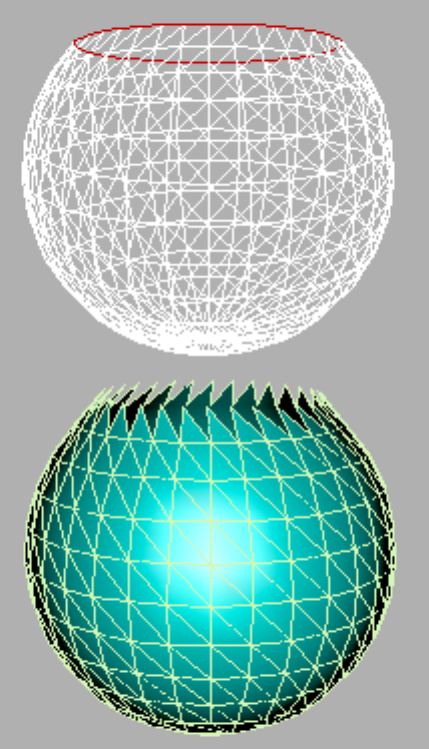
Original patch with edges selected (top) and three-sided patches added (bottom)
Add Tri adds a three-sided patch to each selected edge. Select one or more
edges, then click Add Tri to add the patch or patches.
Add Quad adds a four-sided patch to each selected edge. Select one or more
edges, and then click Add Quad to add the patch or patches.
Create (Vertex, Patch, and Element levels only) Lets you add geometry to
the patch object. Available at Vertex, Patch, and Element sub-object levels
only.
1972 | Chapter 10 Surface Modeling
At the Vertex sub-object level, turn on Create and then click anywhere to add
vertices to the object.
At the Patch and Element levels, you can add three- and four-sided patches.
The cursor changes to white cross hairs when over an existing patch vertex.
Select an existing vertex by clicking it. Click in free space to create a new
vertex at that location; this vertex is included in the sequence of vertices for
the new patch.
■To create a Tri Patch: Click three times in free space or on existing vertices.
Right-click anywhere, or left-click one of the vertices in the current
sequence to complete the creation of a Tri Patch.
■To create a Quad Patch: Click four times in free space or on existing vertices.
The Quad Patch is automatically created at the fourth click.
No operation takes place if you right-click or select a vertex in the current
sequence with only one or two vertices in the sequence.
Detach (Patch and Element levels only) Lets you select one or more patches
or elements within the current object and then detach them (or copy them)
to form a separate patch object.
■Reorient When on, the detached patch or element copies the position
and orientation of the source object's Local coordinate system (when the
source object was created). The new detached object is moved and rotated
so that its Local coordinate system is positioned and aligned with the origin
of the current active grid.
■Copy When on, the detached patches or elements are copied to a new
patch object, leaving the originals intact.
Attach Lets you attach an object to the currently selected patch object. Click
the object you want to attach to the currently selected patch object.
If you attach a non-patch object, the object is converted to a patch object.
When you attach an object, the materials of the two objects are combined in
the following way:
■If the object being attached does not have a material assigned, it inherits
the material of the object it is being attached to.
■Likewise if the object you're attaching to doesn't have a material, it inherits
the material of the object being attached.
Geometry Rollout (Patch) | 1973
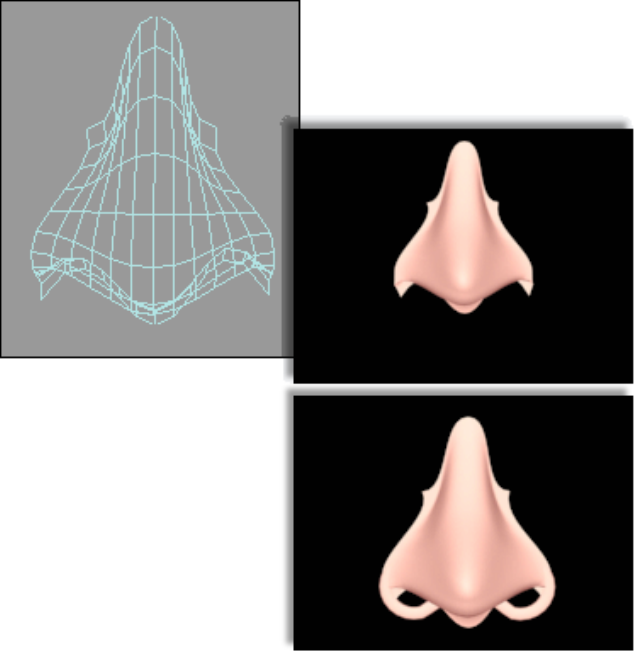
■If both objects have materials, the resulting new material is a
multi/sub-object material on page 5558 that encompasses the input materials.
A dialog appears offering three methods of combining the objects' materials
and material IDs. For more information, see Attach Options Dialog on
page 2031 .
Attach remains active in all sub-object modes, but always applies to objects.
Top: Original patch object with rendering
Bottom: Rendering with another patch attached
Reorient When on, reorients the attached element so that each patch's
creation local coordinate system is aligned with the creation local coordinate
system of the selected patch.
1974 | Chapter 10 Surface Modeling
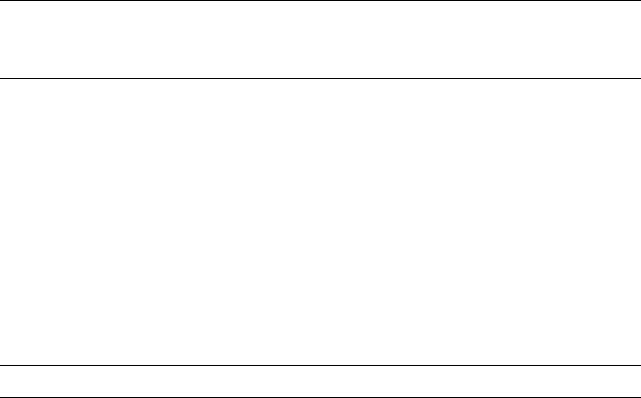
Delete (Vertex, Edge, Patch, and Element levels only) Deletes the selected
sub-objects.
WARNING Delete vertices or edges with caution. Deleting a vertex or edge also
deletes the patches that share them. For example, if you delete the single vertex
at the top of a spherical patch, the top four patches are also deleted.
Break (Vertex and Edge levels only) For vertices, breaks a vertex into multiple
vertices. Use this if you need to split open an edge to add another patch or
for general modeling operations. Select a vertex, and then click Break. After
the break, select the individual vertices and move them to separate the edges.
For edges, splits an edge. Use this if you need to split open an edge for general
modeling operations. Select one or more edges, and then click Break. After
the break, move the handles of adjacent vertices to create a gap in the patch.
Hide (Vertex, Edge, Patch, and Element levels only) Hides the selected
sub-objects. For vertices and edges, Hide also hides the patches that are attached
to them.
NOTE At least one patch in the object must remain visible.
Unhide All Restores any hidden sub-objects to visibility.
Weld group (Vertex and Edge levels only)
Selected Welds selected vertices that fall within the tolerance specified in
the Weld Threshold spinner (to the right of the Weld button). Select the
vertices you want to weld between two different patches, set the spinner to a
sufficient distance, and click Selected.
At the Edge sub-object level, clicking Selected welds two edges that share
vertices. You can use this to eliminate gaps on a surface.
Target (Vertex level only) Turn on and drag from one vertex to another to
weld the vertices together. The dragged vertex fuses to the target vertex.
The pixels spinner to the right of the Target button sets the maximum distance
in screen pixels between the mouse cursor and the target vertex.
Extrude & Bevel group (Edge, Patch, and Element levels only)
These controls let you extrude and bevel edges, patches, or elements. Extruding
patches moves them along a normal and creates new patches that form the
sides of the extrusion, connecting the selection to the object. Beveling adds
a second step that lets you scale the extruded patches. You can extrude and
Geometry Rollout (Patch) | 1975

bevel patches by dragging or by direct entry. You can also hold down the Shift
key during extrusion, which creates a separate element.
NOTE Sides created by beveling or extrusion are assigned to smoothing group
1.
Extrude Click this button, and then drag any edge, patch, or element to
extrude it interactively. Hold down the Shift key during this operation to create
a new element.
When the mouse cursor is over a selected patch or element, it changes to an
Extrude cursor.
Bevel (Patch and Element levels only) Click this button, and then drag any
patch or element to extrude it interactively, then click and release the mouse
button, and drag again to bevel the extrusion. Hold down the Shift key during
this operation to create a new element.
When the mouse cursor is over a selected element, it changes to a Bevel cursor.
1976 | Chapter 10 Surface Modeling
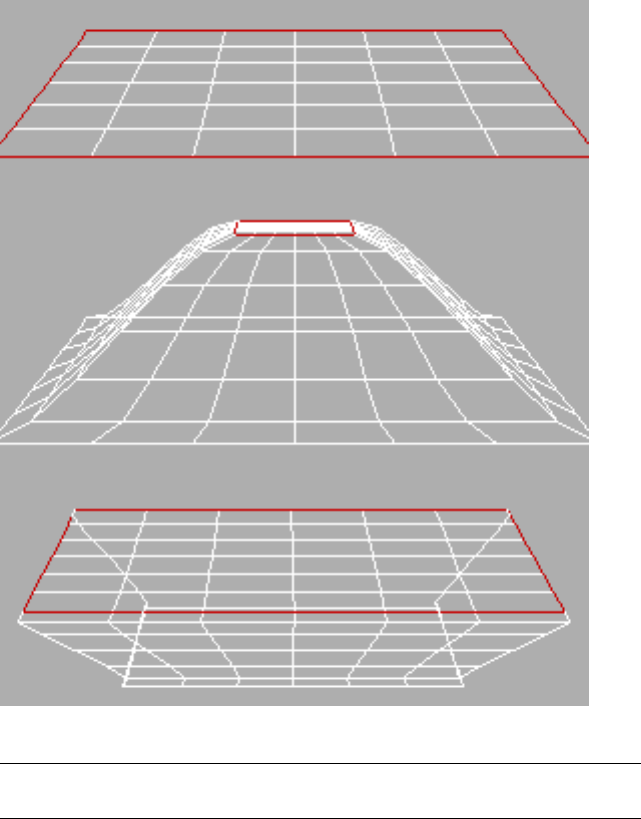
Original patch (top) and inward and outward extrusions
NOTE In some cases, particularly with closed objects (objects with no holes or
open edges), the second bevel step might not produce visible results.
Extrusion This spinner sets whether the extrusion is outward or inward,
depending on whether the value is positive or negative.
Outlining (Patch and Element levels only) This spinner lets you scale selected
patches or elements bigger or smaller, depending on whether the value is
positive or negative. It is normally used after an extrusion for beveling the
extruded patches.
Geometry Rollout (Patch) | 1977
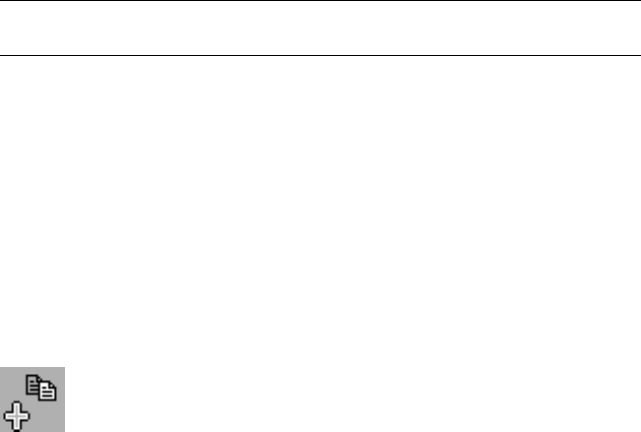
Normal If Normal is set to Local (the default), extrusion takes place along
the normal of each selected edge, patch, or individual patch in an element.
If normal is set to Group, extrusion takes place along the averaged normal of
each contiguous group in a selection. If you extrude multiples of such groups,
each group moves along its own averaged normal.
Bevel Smoothing (Patch and Element levels only) These settings let you set
the shape of the intersection between the surface created by a beveling
operation and the neighboring patches. The shapes are determined by the
handle configurations of vertices at the intersections. Start refers to the
intersection between the sides and the patches surrounding the beveled patch.
Finish refers to the intersection between the sides and the beveled patch or
patches. The following settings are available for each:
■Smooth Vertex handles are set so the angles between the new patches
and their neighbors are relatively small.
■Linear Vertex handles are set to create linear transitions.
■None Vertex handles are not modified.
WARNING Set Bevel Smoothing before the bevel is performed; changing the
setting has no effect on existing beveled patches.
Tangent group (Vertex and Handle levels only)
These controls let you copy orientation, and optionally length, between
handles on the same object, or on different objects applied with instances of
the same Edit Patch modifier. The tool doesn't support copying handles from
one patch object to another, or between spline and patch objects.
Copy Copies a patch handle's transform settings to a copy buffer.
When you click Copy, 3ds Max displays all handles on the selected object.
When the mouse cursor is over a handle end, the cursor image changes to the
one shown below. Click a handle end to copy its direction and length to the
paste buffer; this also exits Copy mode.
Paste Pastes orientation information from the copy buffer to a vertex handle.
If Paste Length is on, it also pastes the length of the copied handle.
When you click Paste, the software displays all handles on the selected object.
When the mouse cursor is over a handle end, the cursor image changes to the
1978 | Chapter 10 Surface Modeling

one shown below. Click a handle end to paste the information from the buffer
to the handle. You can continue clicking other handle ends to paste the
information repeatedly. To exit Paste mode, right-click in the viewport or click
the Paste button.
Copy Length / Paste Length When on and you use Copy, the length of the
handle is also copied. When on and you use Paste, the length of the originally
copied handle is pasted as well as its orientation. When off, only the
orientation is copied or pasted.
Surface group
View Steps Controls the grid resolution of the patch model surface as
depicted in the viewports. Range=0 to 100. Default=5.
Render Steps Controls the grid resolution of the patch model surface when
rendered. Range=0 to 100. Default=5.
Geometry Rollout (Patch) | 1979
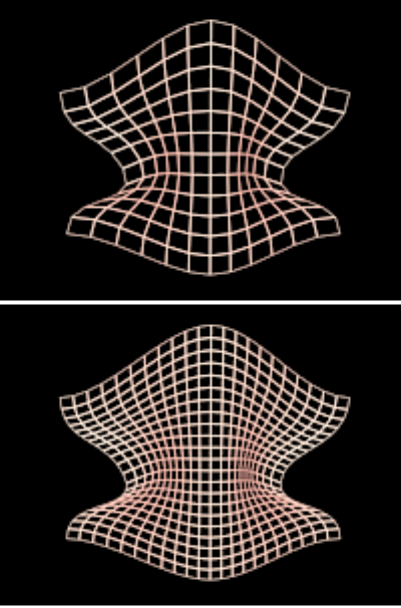
Original mesh display of model (top) and with increased steps (bottom)
Show Interior Edges Enables the display of the patch object's interior edges
in wireframe views. When off, only the object's outline is visible. Turn on to
simplify the display for faster feedback.
Use True Patch Normals Determines how the software smoothes the edges
between patches. Default=off.
When the check box is off, the software computes the surface normals from
the smoothing groups of the mesh object to which the patch object is
converted before rendering. These normals are not accurate, especially with
a low View/Render Steps setting. When the check box is on, the software
computes true patch normals directly from the patch surfaces, which can
generate more accurate shading.
In the illustration below, a sphere was converted to Editable Patch format,
and then a vertex was moved toward the center and rotated. The sphere on
1980 | Chapter 10 Surface Modeling
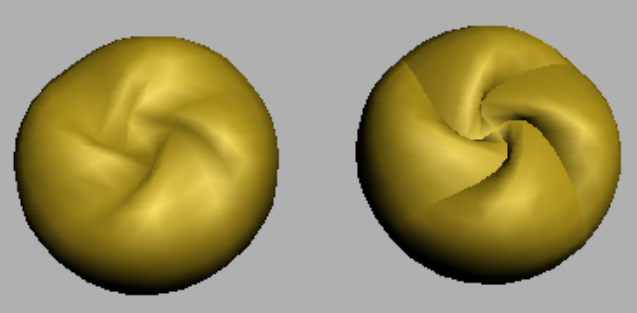
the left has Use True Patch Normals turned off, and the one on the right has
it turned on. In both cases, View Steps was set to 8.
A patch sphere with Use True Patch Normals off (left) and on (right).
Miscellaneous group
Create Shape (Edge level only) Creates splines based on the selected edges.
If no edges are selected, then splines are created for all the patch edges. 3ds
Max prompts you for a name: type in a name for the new shape object, and
then click OK.
Each patch edge forms an individual spline. You can use this to create a spline
cage based on patch edges. This is useful for spline modeling or working with
surface tools.
Patch Smooth At the sub-object level, adjusts the tangent handles of the
vertices of selected sub-objects to smooth the surface of the patch object. At
the object level, adjusts all tangent handles to smooth the surface.
Patch Smooth sets the handles to absolute positions based on the patch object
geometry; repeated applications have no effect.
Geometry Rollout (Patch) | 1981
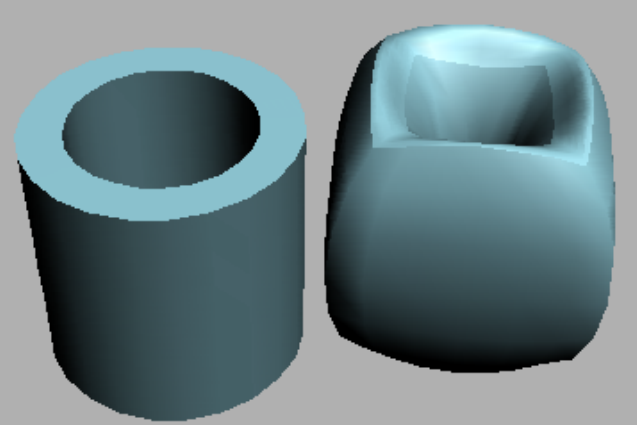
A patch tube before smoothing (left) and after using Patch Smooth (right)
Patch Grids
Create panel > Geometry > Patch Grids
Create menu > Patch Grids
You can create two kinds of patch surfaces in grid form: Quad Patch and Tri
Patch. Patch grids begin as flat plane objects but can be modified into arbitrary
3D surfaces by either using an Edit Patch modifier or collapsing the grid’s
modifier stack down to an Editable Patch in the Modify panel.
Patch grids provide convenient "building material" for custom surfaces and
objects, or for adding patch surfaces to existing patch objects.
You can animate the surface of a Patch object using various modifiers such as
the Flex and Morph modifiers. Control vertices and tangent handles of a patch
surface can be animated with an Editable Patch modifier.
Surface Tools
The output of the Surface modifier on page 1695 is a Patch object. Patch objects
offer a flexible alternative to mesh and NURBS modeling and animation.
1982 | Chapter 10 Surface Modeling
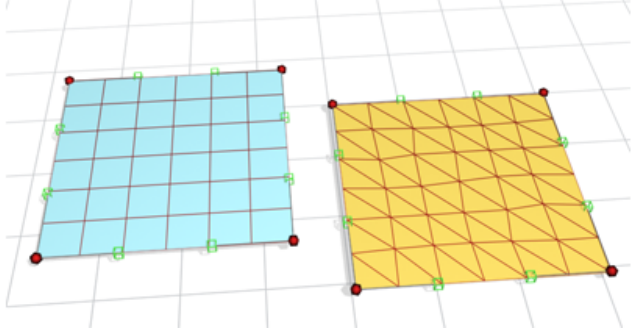
Quad patch and tri patch
Editable Patches
You can convert a basic patch grid to an editable patch object on page 1934 .
The editable patch has a variety of controls that let you directly manipulate
it and its sub-objects. For example, at the Vertex sub-object level, you can
move vertices or adjust their Bezier handles. Editable patches let you create
surfaces that are less regular, more free-form than the basic, rectangular patches.
When you convert a patch to an editable patch, you lose the ability to adjust
or animate its creation parameters.
See also:
■Edit Modifiers and Editable Objects on page 1027
■Modifying at the Sub-Object Level on page 1029
■Modifier Stack Controls on page 7427
Procedures
To create a patch grid:
1On the Create panel > Geometry > Patch Grids > Object Type rollout,
click either Quad Patch or Tri Patch.
2Drag over any viewport to create a patch.
Patch Grids | 1983

Interface
AutoGrid Uses surface normals as a plane to create patches. Click a patch
type and then click and drag the cursor over a face in the viewports.
Detailed information about the two patch grid types is available in these topics:
Quad Patch on page 1984
Tri Patch on page 1987
Quad Patch
Create panel > Geometry > Patch Grids > Quad Patch
Create menu > Patch Grids > Quad Patch
Quad Patch creates a flat grid with a default of 36 visible rectangular facets.
A hidden line divides each facet into two triangular faces for a total of 72 faces.
1984 | Chapter 10 Surface Modeling
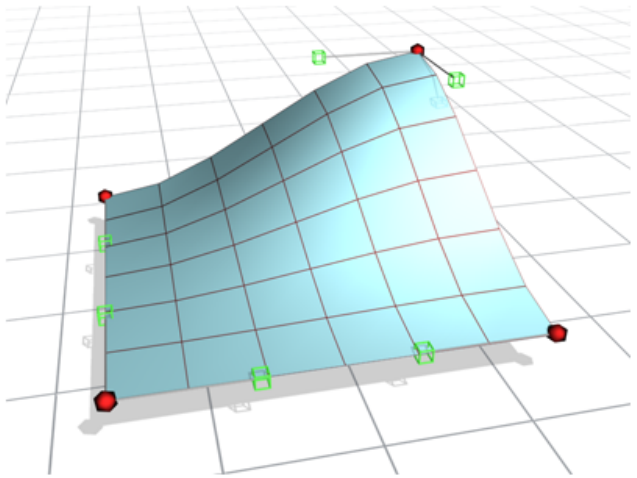
Quad Patch
Procedures
To create a patch grid:
1On the Create panel > Geometry > Patch Grids > Object Type rollout,
click either Quad Patch or Tri Patch.
2Drag over any viewport to define a length and width for the patch.
To edit a Quad Patch:
1Select a Quad Patch.
2On the Modify panel, right-click Quad Patch in stack view and choose
Editable Patch.
The Quad Patch collapses to an Editable Patch.
3On the Editable Patch Selection rollout, click Vertex.
4In any viewport, select a vertex on the patch object, and move the vertex
to change the surface topology.
Quad Patch | 1985

Vertices and vectors can be animated with an Editable Patch modifier.
At the sub-object Edge level, you can add patches along any edge. You can
create complex patch models beginning from a single patch.
An ear is created by adding patches and editing patch vertices
Interface
1986 | Chapter 10 Surface Modeling
Name and Color rollout
The Name and Color rollout on page 7423 lets you rename objects and change
their wireframe color.
Keyboard Entry rollout
X/Y/Z Sets the patch center.
Length Sets the patch length.
Width Sets the patch width.
Create Creates a patch based on the XYZ, Length, and Width values.
Parameters rollout
Length, Width Sets the grid dimensions in current units.
Length, Width Segments Determines the number of facets along the length
and width of the grid. Default=1.
The density of a Quad Patch rises sharply as you increase the segments. A
Quad Patch of two segments on a side contains 288 faces. The maximum is
100 segments. High segment values can slow performance.
Generate Mapping Coordinates Creates map coordinates for applying
mapped materials. Default=off.
Tri Patch
Create panel > Geometry > Patch Grids > Tri Patch
Create menu > Patch Grids > Tri Patch
Tri Patch creates a flat grid with 72 triangular faces. The face count remains
at 72, regardless of its size. The faces become larger to fill the area as you
increase the size of the grid.
Tri Patch | 1987
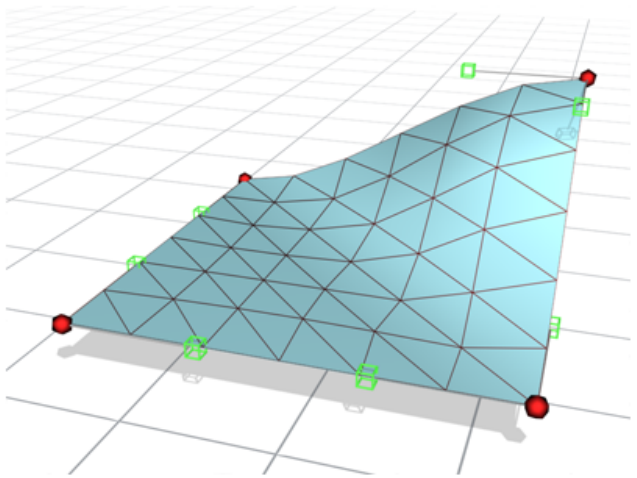
Tri Patch
Procedures
To create a Tri Patch:
1On the Create panel > Geometry > Patch Grids > Object Type rollout,
click Tri Patch.
2Drag over any viewport to create the patch.
To edit a Tri Patch:
1Select a Tri Patch.
2On the Modify panel, right-click TriPatch in stack view, and choose
Editable Patch.
The Tri Patch collapses to an Editable Patch.
3In the Editable Patch Selection rollout, click Vertex.
4In any viewport, select a vertex on the patch object and move the vertex
to change the surface topology.
1988 | Chapter 10 Surface Modeling
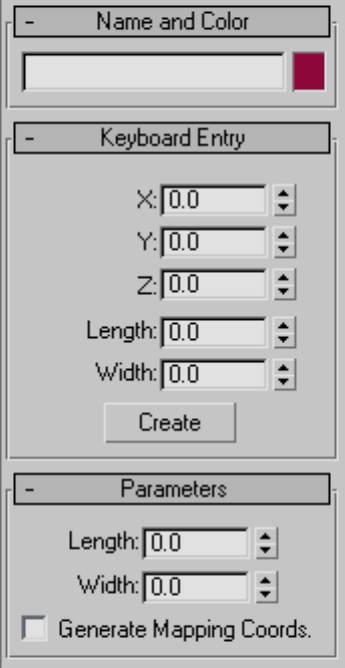
You can animate vertices and vectors with an Editable Patch modifier.
Interface
Name and Color rollout
The Name and Color rollout on page 7423 lets you rename objects and change
their wireframe color.
Keyboard Entry rollout
X/Y/Z Sets the patch center.
Tri Patch | 1989
Length Sets the patch length.
Width Sets the patch width.
Create Creates a patch based on the XYZ, Length, and Width values.
Parameters rollout
Length, Width Sets dimensions of grid in current units.
Generate Mapping Coordinates Creates map coordinates for applying
mapped materials. Default=off.
Editable Mesh Surface
Create or select an object. > Quad menu > Transform quadrant > Convert To:
submenu > Editable Mesh
Create or select an object. > Modify panel > Right-click the base object in the
stack. > Convert to: Editable Mesh
Create or select an object. > Utilities panel > Collapse button > Collapse
Selected button
Editable Mesh on page 7765 , like the Edit Mesh modifier, provides controls for
manipulating a mesh object made up of triangular faces as an object and at
three sub-object levels: vertex, edge and face. You can convert most objects
in 3ds Max to editable meshes, but for open spline objects, only vertices are
available, because open splines have no faces or edges when converted to
meshes.
To make a sub-object selection on a non-editable mesh object (for example,
a primitive) for passing up the stack to a modifier, use the Mesh Select modifier
on page 1455 .
Once you make a selection with Editable Mesh, you have these options:
■Use the options supplied on the Edit Geometry rollout to modify the
selection. Later topics discuss these options for each of the mesh
components.
■Transform or Shift+clone the selection, as with any object.
■Pass the selection to a later modifier in the stack. You can apply one or
more standard modifiers to the selection.
1990 | Chapter 10 Surface Modeling
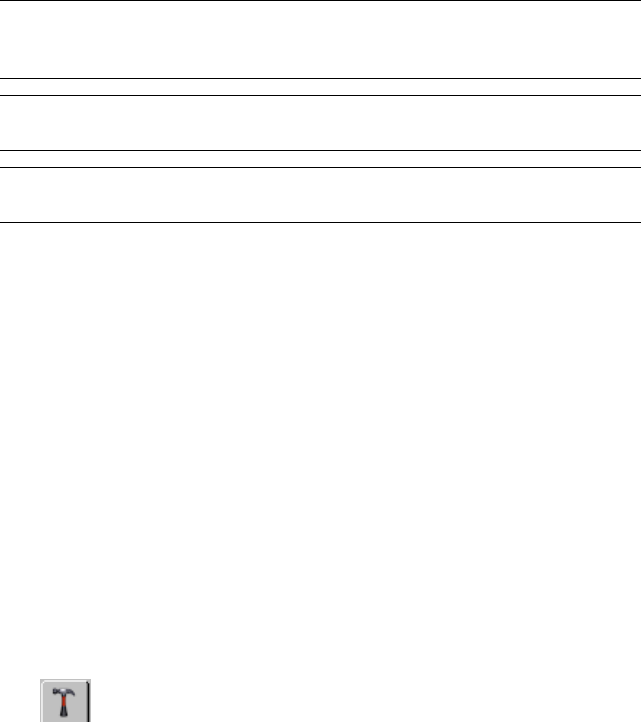
■Use the options on the Surface Properties rollout to alter the surface
characteristics of selected mesh components.
NOTE Because Edit Mesh modifier functionality is almost identical to that of
editable mesh objects, features described in the Editable Mesh topics also apply
to objects with Edit Mesh applied, except as noted.
TIP Editable Poly on page 2038 is similar to Editable Mesh, but lets you work with
polygons of four or more sides, and provides a greater range of functionality.
TIP You can exit most Editable Mesh command modes, such as Extrude, by
right-clicking in the active viewport.
See also:
■Edit Modifiers and Editable Objects on page 1027
■Modifying at the Sub-Object Level on page 1029
■Modifier Stack Controls on page 7427
■Edit Mesh Modifier on page 1283
■Mesh Select Modifier on page 1455
Procedures
To produce an editable mesh object:
First select the object, and then do one of the following:
1Right-click the object and choose Editable Mesh from the Convert To
submenu in the transform quadrant.
2 Use the Collapse utility on page 1931 .
3Apply a modifier to a parametric object that turns the object into a mesh
object in the stack, and then collapse the stack. (For example, you can
apply a Mesh Select modifier.)
4Apply an Edit Mesh or Mesh Select modifier to an object.
5Import a non-parametric object, such as that found in a 3DS file.
6Import a 3ds Max object using File menu > Merge.
Editable Mesh Surface | 1991
Converting an object to an editable mesh removes all parametric controls,
including the creation parameters. For example, you can no longer increase
the number of segments in a box, slice a circular primitive, or change the
number of sides on a cylinder. Any modifiers you apply to an object are
collapsed as well. After conversion, the only entry left on the stack is "Editable
Mesh."
Maintaining an object's creation parameters:
As described in the above procedure, you can convert an existing object to an
editable mesh, which replaces the creation parameters in the stack with
"Editable Mesh." The creation parameters are no longer accessible or
animatable. If you want to maintain the creation parameters, you can use the
following modifiers:
■Edit Mesh Modifier on page 1283
■Mesh Select Modifier on page 1455
■Delete Mesh Modifier on page 1266
■Tessellate Modifier on page 1743
■Face Extrude Modifier on page 1381
■Affect Region Modifier on page 1133
Interface
Modifier Stack display
Show End Result Normally, if you apply a modifier such as Twist to an
editable-mesh object and then return to the Editable Mesh stack entry, you
cannot see the effect of the modifier on the object's geometry. But if you turn
on Show End Result while in sub-object level, you can see the original
sub-object selection as a yellow mesh, the final object as a white mesh, and
the original editable mesh as an orange mesh.
Selection rollout
See Selection Rollout (Editable Mesh) on page 1995 .
Named Selections
Copy Places a named selection into the copy buffer.
Paste Pastes a named selection from the copy buffer.
1992 | Chapter 10 Surface Modeling

For more information, see Named Selection Sets on page 179 .
Selection Information
At the bottom of the Selection rollout is a text display giving information
about the current selection. If no objects or more than one sub-object are
selected, the text gives the number of objects and the type selected. If a single
sub-object is selected, the text gives its identification number and type.
NOTE When the current sub-object level is Polygon or Element, selection
information is given in faces.
Soft Selection rollout
Soft Selection controls affect the action of sub-object Move, Rotate, and Scale
functions. When these are on, 3ds Max applies a spline curve deformation to
unselected vertices surrounding the transformed selected sub-object. This
provides a magnet-like effect with a sphere of influence around the
transformation.
For more information, see Soft Selection Rollout on page 1926 .
Edit Geometry rollout
The Edit Geometry rollout on page 2018 provides various controls for editing
an editable mesh object and its sub-objects. For information specific to the
different sub-object levels, click any of the links below:
Editable Mesh (Object) on page 1998
Editable Mesh (Vertex) on page 2001
Editable Mesh (Edge) on page 2007
Editable Mesh (Face/Polygon/Element) on page 2014
Working with Mesh Sub-Objects
This topic describes how to work with sub-object selections when you are
editing an Editable Mesh on page 1990 .
See also:
■Edit Modifiers and Editable Objects on page 1027
Working with Mesh Sub-Objects | 1993
■Modifying at the Sub-Object Level on page 1029
■Modifier Stack Controls on page 7427
■Editable Mesh on page 7765
■Editable Poly on page 7765
Selecting and Transforming
In selecting and transforming sub-object geometry, you use standard
techniques:
■Clicking any vertex, edge, or face/polygon/element selects it.
■Holding down Ctrl lets you add to or subtract from the selection with single
clicks.
■Holding down Alt lets you a subtract from the selection with single clicks,
or with Window/Crossing selections.
■Beginning a selection outside the object starts a region selection. Holding
down Ctrl during region selection lets you add to the selection.
Once you’ve made a sub-object selection, you can use the Spacebar to lock
the selection while you’re working with it.
Using Sub-Object Selection
With either an editable mesh (or Edit Mesh modifier) or a Mesh Select modifier,
you can store three separate sub-object selections: one for each selection level
(vertex, face, and edge). These selection sets are saved with the file. With
sub-object selections, you have these options:
■Choose one of the selection sets to pass geometry up the stack to other
modifiers. Only one selection set is active at a time.
■Change to one of the other selection sets at any time.
■Use named selection sets on page 179 for sub-object geometry you want
to reuse.
In modeling a head, for example, you might have a number of different
vertex selections for forehead, nose, and chin. Such selections can be
difficult to re-create, so named sets give you easy access to the original
selection when you want to rework a particular area.
1994 | Chapter 10 Surface Modeling
Cloning Sub-Object Geometry
Using Shift+transform with a selection of vertices or faces displays the Clone
Part Of Mesh dialog. This lets you determine whether you want to "Clone To
Object" or "Clone To Element." Click the desired option, optionally giving the
cloned object a new name, then click OK.
■If you choose Clone To Object, the cloned copy becomes a plain mesh
object, entirely separate from the original object. The new object is given
the name in the field to the right of the Clone To Object radio button.
■If you choose Clone To Element, the selection is cloned in its new position
and remains part of the original object.
Animating Sub-Object Geometry
When you work with an editable mesh, you can directly transform and animate
a sub-object selection. In effect, the selection works like any other object.
Selection Rollout (Editable Mesh)
The Selection rollout provides buttons for turning different sub-object levels
on and off, working with named selections and handles, display settings, and
information about selected entities.
When you first access the Modify panel with an editable mesh selected, you're
at the Object level, with access to several functions available as described in
Editable Mesh (Object) on page 1998 . You can toggle the various sub-object
levels, and access relevant functions by clicking the buttons at the top of the
Selection rollout.
Clicking a button here is the same as selecting a sub-object type in the Modifier
Stack display. Click the button again to turn it off and return to the Object
selection level.
The Selection rollout also allows you to display and scale vertex or face
normals on page 7863
Selection Rollout (Editable Mesh) | 1995

Interface
Vertex Turns on Vertex sub-object level, which lets you select a vertex
beneath the cursor; region selection selects vertices within the region.
Edge Turns on Edge sub-object level, which lets you select the edge
of a face or polygon beneath the cursor; region selection selects multiple edges
within the region. At the Edge sub-object level, selected hidden edges are
displayed as dashed lines, allowing for more precise selection.
Face Turns on Face sub-object level, which lets you select a triangular
face beneath the cursor; region selection selects multiple triangular faces within
the region. If a selected face has a hidden edge and Shade Selected Faces on
page 7616 is off, the edge is displayed as a dashed line.
Polygon Turns on Polygon sub-object level, which lets you select all
coplanar faces (defined by the value in the Planar Threshold spinner) beneath
the cursor. Usually, a polygon is the area you see within the visible wire edges.
Region selection selects multiple polygons within the region.
1996 | Chapter 10 Surface Modeling
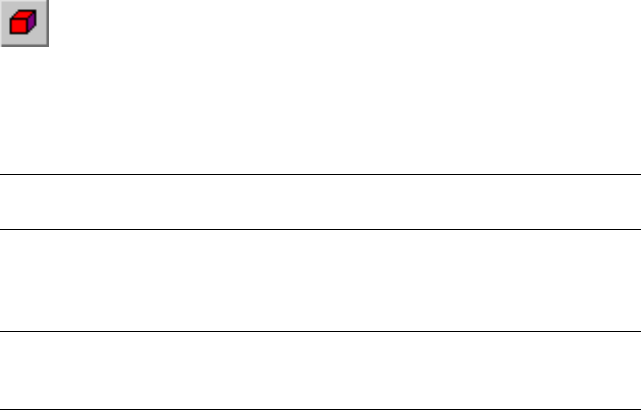
Element Turns on Element sub-object level, which lets you select all
contiguous faces in an object. Region selection lets you select multiple
elements.
By Vertex When on, and you click a vertex, any sub-objects (at the current
level) that use that vertex are selected. Also works with Region Select.
NOTE When By Vertex is on, you can select sub-objects only by clicking a vertex,
or by region.
Ignore Backfacing When on, selection of sub-objects selects only those
sub-objects whose normals are visible in the viewport. When off (the default),
selection includes all sub-objects, regardless of the direction of their normals.
NOTE The state of the Backface Cull setting in the Display panel does not affect
sub-object selection. Thus, if Ignore Backfacing is off, you can still select sub-objects,
even if you can't see them.
Ignore Visible Edges This is enabled when the Polygon face selection method
is chosen. When Ignore Visible Edges is off (the default), and you click a face,
the selection will not go beyond the visible edges no matter what the setting
of the Planar Thresh spinner. When this is on, face selection ignores the visible
edges, using the Planar Thresh setting as a guide.
Generally, if you want to select a "facet" (a coplanar collection of faces), you
set the Planar Threshold to 1.0. On the other hand, if you're trying to select
a curved surface, increase the value depending on the amount of curvature.
■Planar Thresh (Planar Threshold) Specifies the threshold value that
determines which faces are coplanar for Polygon face selection.
Show Normals When on, the program displays normals on page 7863 in the
viewports. Normals are displayed as blue lines.
Show normals is not available in Edge mode.
■Scale Specifies the size of the normals displayed in the viewport when
Show is on.
Delete Isolated Vertices When on, 3ds Max eliminates any isolated vertices
when you delete a contiguous selection of sub-objects. When off, deleting a
selection leaves all vertices intact. Not Available at the Vertex sub-object level.
Default=on.
Selection Rollout (Editable Mesh) | 1997

An isolated vertex is one that has no associated face geometry. For example,
if Delete Isolated Vertices is off and you delete a rectangular selection of four
polygons, all clustered about a single central point, the point remains,
suspended in space.
Hide Hides any selected sub-objects. Edges and entire objects cannot be
hidden.
TIP The Select Invert command on the 3ds Max Edit menu is useful for selecting
faces to hide. Select the faces you want to focus on, choose Edit > Select Invert,
then click the Hide button.
Unhide All Restores any hidden objects to visibility. Hidden vertices can be
unhidden only when in Vertex sub-object level.
Editable Mesh (Object)
Select an editable mesh object or object with the Edit Mesh modifier applied.
> Modify panel
Select an editable mesh object. > Quad menu > Tools 1 quadrant > Top-Level
Editable Mesh (Object) controls are available when no sub-object levels are
active. These controls are also available at all sub-object levels, and work the
same at each level, except as noted in Edit Geometry Rollout (Mesh) on page
2018 .
1998 | Chapter 10 Surface Modeling

Interface
Edit Geometry rollout
See Edit Geometry Rollout (Mesh) on page 2018 for detailed descriptions of
these controls.
Editable Mesh (Object) | 1999
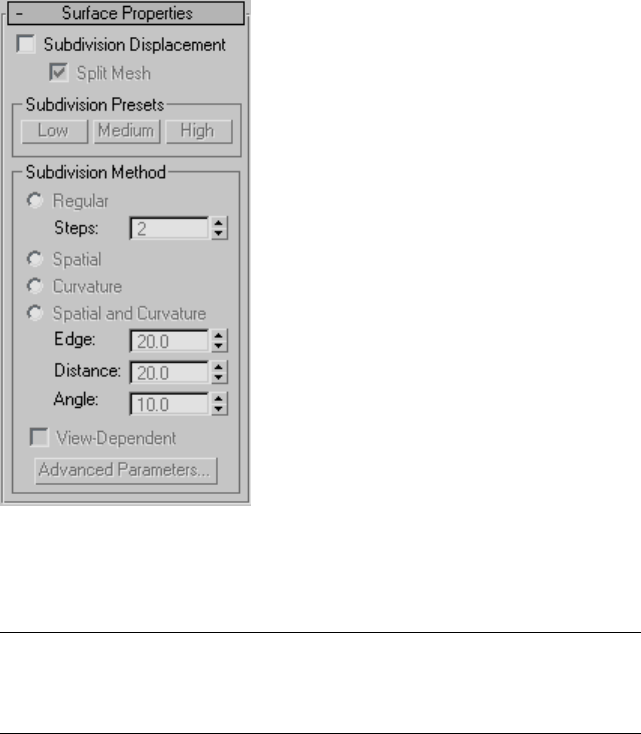
Surface Properties rollout
Specifies surface approximation settings for subdividing the editable mesh.
These controls work like the surface approximation settings for NURBS surfaces
on page 2152 . They are used when you apply a displacement map on page 5391
to the editable mesh.
NOTE The Surface Properties rollout is available only for editable mesh objects;
it does not appear in the Modify panel for an object to which the Edit Mesh
modifier is applied. With Edit Mesh-modified objects, you can use the Disp Approx
modifier on page 1270 to the same effect.
Subdivision Displacement When on, faces are subdivided to accurately
displace the mesh, using the method and settings you specify in the
Subdivision Presets and Subdivision Method group boxes. When off, the mesh
is displaced by moving existing vertices, the way the Displace modifier on
page 1274 does. Default=off.
Split Mesh Affects the seams of displaced mesh objects; also affects texture
mapping. When on, the mesh is split into individual faces before it is displaced;
2000 | Chapter 10 Surface Modeling
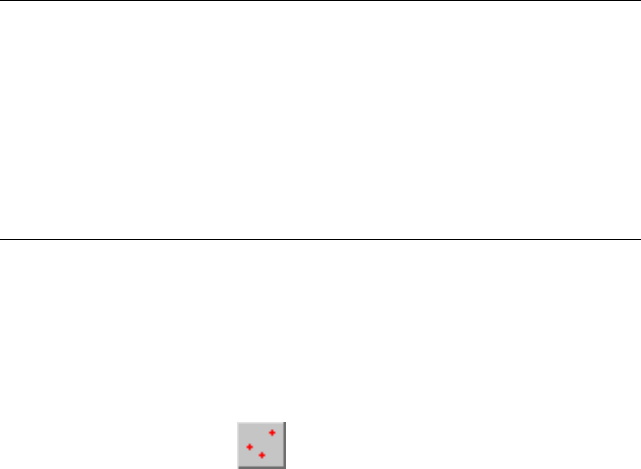
this helps preserve texture mapping. When off, the mesh is not split and an
internal method is used to assign texture mapping. Default=on.
TIP This parameter is required because of an architectural limitation in the way
displacement mapping works. Turning Split Mesh on is usually the better technique,
but it can cause problems for objects with clearly distinct faces, such as boxes, or
even spheres. A box's sides might separate as they displace outward, leaving gaps.
And a sphere might split along its longitudinal edge (found in the rear for spheres
created in the Top view) unless you turn off Split Mesh. However, texture mapping
works unpredictably when Split Mesh is off, so you might need to add a Displace
Mesh modifier on page 1045 and make a snapshot on page 921 of the mesh. You
would then apply a UVW Map modifier on page 1849 and then reassign mapping
coordinates to the displaced snapshot mesh.
Subdivision Presets group & Subdivision Method group
The controls in these two group boxes specify how the displacement map is
applied when Subdivision Displacement is on. They are identical to the Surface
Approximation controls on page 2469 used for NURBS surfaces.
Editable Mesh (Vertex)
Select an editable mesh object. > Modify panel > Selection rollout > Vertex
Select an editable mesh object. > Modify panel > Modifier Stack display >
Expand Editable Mesh. > Vertex
Select an editable mesh object. > Quad menu > Tools 1 quadrant > Vertex
Vertices are points in space: they define the structure of faces. When vertices
are moved or edited, the faces they form are affected as well. Vertices can also
exist independently; such isolated vertices can be used to construct faces but
are otherwise invisible when rendering.
At the Editable Mesh (Vertex) sub-object level, you can select single and
multiple vertices and move them using standard methods.
See also:
■Editable Mesh Surface on page 1990
Editable Mesh (Vertex) | 2001

Procedures
To weld mesh vertices:
You can use either of two methods to combine several vertices into one, also
known as welding. If the vertices are very close together, use the Weld function.
You can also use Weld to combine a number of vertices to the average position
of all of them.
Alternatively, to combine two vertices that are far apart, resulting in a single
vertex that's in the same position as one of them, use Target Weld.
TIP Welding vertices is considerably easier with poly objects. See this procedure:
To weld polygon vertices: on page 2055
1To use Weld:
■On the Selection rollout, turn on Ignore Backfacing, if necessary. This
ensures that you're welding only vertices you can see.
■Select the vertices to weld.
■If the vertices are very close together, go to the Edit Geometry rollout
> Weld group and click Selected. If that doesn't work (you get a “No
vertices within weld threshold.” message), proceed to the next step.
■Increase the numeric value to the right of the Selected button.
This is the threshold value; the minimum distance that vertices can
be apart from each other to be welded.
■Click Selected again.
At this point, one of three things happens: None, some, or all of the
vertices are welded. If the latter, you're done. If either of the others
occurs, proceed to the next step.
■Continue increasing the threshold value and clicking Selected until
all of the vertices are welded.
2To use Target Weld:
1On the Selection rollout, turn on Ignore Backfacing, if necessary.
This ensures that you're welding only vertices you can see.
2Find two vertices you want to weld, and determine the ultimate
location of the resulting vertex. You can weld any two vertices, but
for best results the two should be contiguous; that is, they should
be connected by a single edge.
2002 | Chapter 10 Surface Modeling
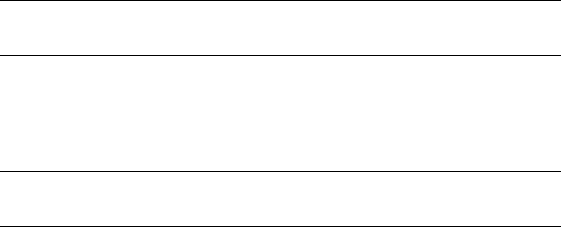
For this example, we'll call the vertices A and B, and the resulting
vertex will be at vertex B's location.
3Click the Target button.
The button stays highlighted, to indicate that you're now in Target
Weld mode.
4Drag vertex A to Vertex B.
While you're dragging, the mouse cursor image is a four-headed,
+-shaped arrow. When over an eligible target vertex, the cursor
changes to a crosshairs.
TIP If you have trouble dragging in the proper direction, open the Axis
Constraints toolbar on page 7288 and click the XY button.
5Release the mouse button.
The pair is welded. The resulting vertex remains at vertex B's position,
and you exit Target Weld mode.
TIP If you have trouble combining the two vertices, try increasing the
Pixels value with the spinner to the right of the Target button.
You remain in Target Weld mode, and can continue to weld pairs
of vertices.
6Exit Target mode by right-clicking in the active viewport or clicking
the Target button again.
To select vertices by color:
1On the Surface Properties rollout, click the Existing Color swatch, and
specify the color of vertex you want in the Color Selector.
2Specify ranges in the RGB Range spinners. This lets you select vertices
that are close to the specified color, but don't match exactly.
3Click the Select button.
All vertices matching the color, or within the RGB range, are selected.
You can add to the selection by holding Ctrl as you click the Select button,
and you can subtract from the selection by holding the Alt key.
Editable Mesh (Vertex) | 2003

TIP You can select all vertices of the same color by first selecting the vertex
you want matched, dragging a copy of the Edit Color swatch to the Existing
Color swatch, and then clicking the Select button. (If you want an exact
match, be sure to set the RGB Range spinners to 0 first.)
Interface
Selection rollout
For information on the Selection rollout settings, see Editable Mesh on page
1992 .
Soft Selection rollout
Soft Selection controls affect the action of sub-object Move, Rotate, and Scale
functions. When these are on, the program applies a spline curve deformation
to unselected vertices surrounding the transformed selected sub-object. This
provides a magnet-like effect with a sphere of influence around the
transformation.
For more information, see Soft Selection Rollout on page 1926 .
2004 | Chapter 10 Surface Modeling

Edit Geometry rollout
See Edit Geometry Rollout (Mesh) on page 2018 for detailed descriptions of
these controls.
Editable Mesh (Vertex) | 2005
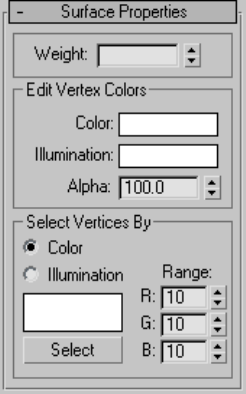
Surface Properties rollout
These controls let you set the weight and color for vertices.
Weight Displays and lets you change vertex weights for NURMS operations
(see MeshSmooth Modifier on page 1460 ).
Edit Vertex Colors group
Use these controls to assign the color, illumination color (shading), and alpha
(transparency) values of selected vertices.
Color Click the color swatch to change the color of selected vertices.
Illumination Click the color swatch to change the illumination color of
selected vertices. This lets you change the illumination of a vertex without
changing the vertex's color.
Alpha Lets you assign an alpha (transparency) value to selected vertices.
The spinner value is a percentage; zero is completely transparent and 100 is
completely opaque.
Select Vertices By group
Color/Illumination These radio buttons let you choose to select vertices by
vertex color value or vertex illumination value. Set the desired options and
then click Select.
2006 | Chapter 10 Surface Modeling

Color Swatch Displays the current color to match. Click to open the Color
Selector, where you can specify a different color.
Select Depending on which radio button is selected, selects all vertices whose
vertex color or illumination values either match the color swatch, or are within
the range specified by the RGB spinners.
Range Specifies a range for the color match. All three RGB values in the
vertex color or illumination color must either match the color specified by
the Color swatch in Select By Vertex Color, or be within a range determined
by adding and subtracting the Range values from the displayed color.
Default=10.
For example, if you've chosen Color and set the color swatch to medium gray
(R=G=B=128), and are using the default Range values of 10,10,10, then clicking
the Select button selects only vertices set to RGB color values between
118,118,118 and 138,138,138.
Editable Mesh (Edge)
Select an editable mesh object. > Modify panel > Selection rollout > Edge
Select an editable mesh object. > Modify panel > Modifier Stack display >
Editable Mesh rollout > Edge
Select an editable mesh object. > Quad menu > Tools 1 quadrant > Edge
An edge is a line, visible or invisible, forming the side of a face and connecting
two vertices. Two faces can share a single edge.
At the Editable Mesh (Edge) sub-object level, you can select single and multiple
edges and transform them using standard methods.
See also:
■Editable Mesh Surface on page 1990
Procedures
To create a shape from one or more edges:
1Select the edges you want to make into shapes.
2On the Edit Geometry rollout, click Create Shape From Edges.
Editable Mesh (Edge) | 2007
3Make changes, as needed, on the Create Shape dialog that appears.
■Enter a curve name or keep the default.
■Choose Smooth or Linear as the Shape Type.
■Turn on Ignore Hidden Edges to exclude hidden edges from the
calculation, or turn this feature off.
4Click OK.
The resulting shape consists of one or more splines whose vertices are
coincident with the vertices in the selected edges. The Smooth option
results in vertices using smooth values, while the Linear option results
in linear splines with corner vertices.
When you region-select edges, all edges are highlighted, including hidden
edges, which are displayed as dashed lines. As a default, the Create Shape
function ignores the hidden edges, even though they're selected. Turn
off Ignore Hidden Edges if you want to include the hidden edges in the
calculation.
If the selected edges are not continuous, or if they branch, the resulting
shape will consist of more than one spline. When the Create Shape
function runs into a branching 'Y' in the edges, it makes an arbitrary
decision as to which edge produces which spline. If you need to control
this, select only those edges that will result in a single spline, and perform
Create Shape repeatedly to make the correct number of shapes. Finally,
use Attach in the Editable Spline to combine the shapes into one.
2008 | Chapter 10 Surface Modeling
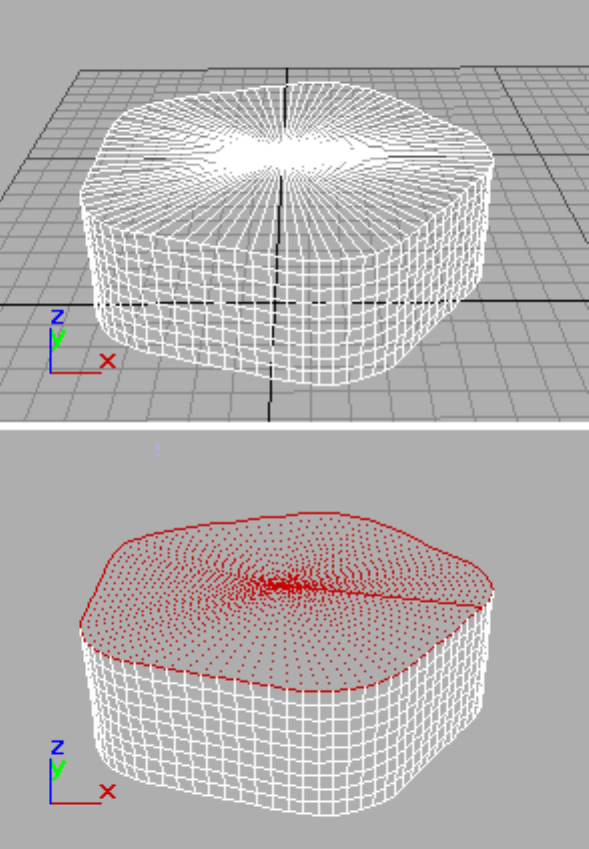
Top: Original object
Bottom: Object with edges selected
Editable Mesh (Edge) | 2009
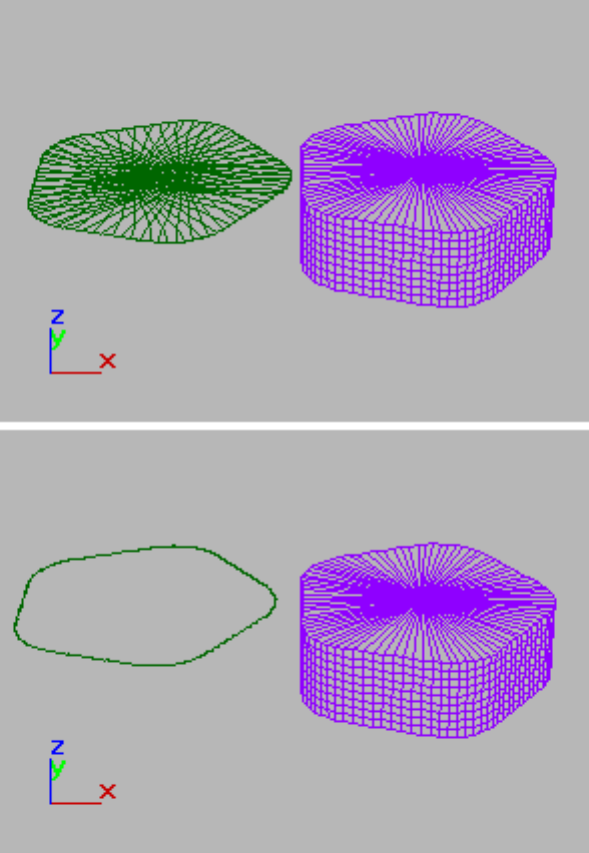
Top: Selected edges removed from original object
Bottom: Unwanted edges removed
2010 | Chapter 10 Surface Modeling
Interface
Selection rollout
See Editable Mesh on page 1992 for information on the Selection rollout
settings.
Soft Selection rollout
Soft Selection controls affect the action of sub-object Move, Rotate, and Scale
functions. When these are on, the software applies a spline curve deformation
to unselected vertices surrounding the transformed selected sub-object. This
provides a magnet-like effect with a sphere of influence around the
transformation.
For more information, see Soft Selection Rollout on page 1926 .
Editable Mesh (Edge) | 2011

Edit Geometry rollout
See Edit Geometry Rollout (Mesh) on page 2018 for detailed descriptions of
these controls.
2012 | Chapter 10 Surface Modeling
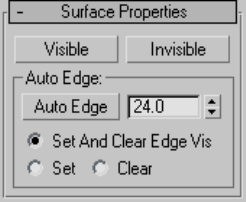
Surface Properties rollout
These controls affect the visibility of the edges. Invisible edges (also called
construction lines) appear in the viewports when Edges Only is turned off in
the Display command panel, or when you're editing at the Edge sub-object
level. The visibility of edges is primarily of importance when an object is being
rendered using a wireframe material.
Visible Makes selected edges visible.
Invisible Makes selected edges invisible, so they won't be displayed in Edges
Only mode.
Auto Edge group
Auto Edge Automatically determines edge visibility based on the angle
between the faces that share the edge, with the angle set by the Threshold
spinner to its right.
Clicking Auto Edge can have one of three effects, depending on which radio
button is active (Set means to make an invisible edge visible; Clear means to
make a visible edge invisible):
■Set and Clear Edge Vis Can change the visibility of all selected edges
depending on the Threshold setting.
■Set Makes previously invisible edges visible only if they exceed the
Threshold setting; does not clear any edges.
■Clear Makes previously visible edges invisible only if they are less than
the Threshold setting; does not make any edges visible.
Editable Mesh (Edge) | 2013

Editable Mesh (Face/Polygon/Element)
Select an editable mesh object. > Modify panel > Selection rollout >
Face/Polygon/Element
Select an editable mesh object. > Modify panel > Modifier Stack display >
Editable Mesh rollout > Face/Polygon/Element
Select an editable mesh object. > Quad menu > Tools 1 quadrant >
Face/Polygon/Element
A face is the smallest possible mesh object: a triangle formed by three vertices.
Faces provide the renderable surface of an object. While a vertex can exist as
an isolated point in space, a face cannot exist without vertices.
At the Editable Mesh (Face) level, you can select single and multiple faces and
transform them using standard methods. This is also true for the Polygon and
Element sub-object levels; for the distinctions between face, polygon, and
element, see Editable Mesh > Selection rollout on page 1992 .
See also:
■Editable Mesh Surface on page 1990
Interface
Selection rollout
For information on the Selection rollout settings, see Editable Mesh on page
1992 .
Soft Selection rollout
Soft Selection controls affect the action of sub-object Move, Rotate, and Scale
functions. When these are on, 3ds Max applies a spline curve deformation to
unselected vertices surrounding the transformed selected sub-object. This
provides a magnet-like effect with a sphere of influence around the
transformation.
For more information, see Soft Selection Rollout on page 1926 .
2014 | Chapter 10 Surface Modeling

Edit Geometry rollout
See Edit Geometry Rollout (Mesh) on page 2018 for detailed descriptions of
these controls.
Editable Mesh (Face/Polygon/Element) | 2015
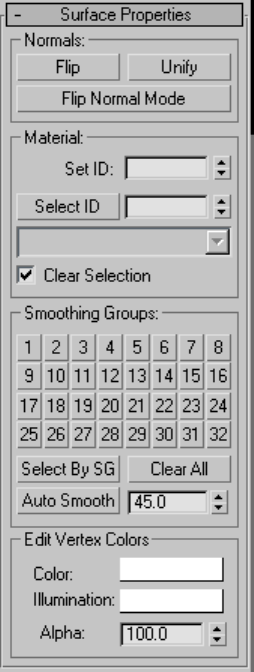
Surface Properties rollout
These controls let you work with face normals, material IDs, smoothing groups
and vertex colors.
Normals group
Flip Reverses the direction of the surface normals of the selected faces.
Unify Flips the normals of an object so that they all point in the same
direction, usually outward. This is useful for restoring an object's faces to their
original orientations. Sometimes normals of objects that have come into 3ds
Max as part of a DXF file are irregular, depending on the methods used to
create the objects. Use this function to correct them.
2016 | Chapter 10 Surface Modeling
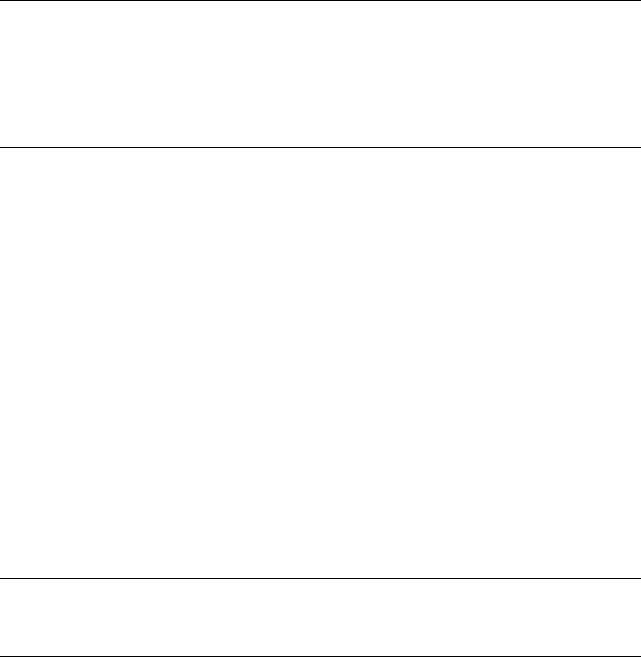
Flip Normal Mode Flips the normal of any face you click. To exit, click this
button again or right-click anywhere in the program interface.
TIP The best way to use Flip Normal mode is to set up your viewport to display
with Smooth+Highlight and Edged Faces on. If you use Flip Normal mode with
default settings, you'll be able to flip a face away from you, but you won't be able
to flip it back. For best results, turn off Ignore Backfacing in the Selection rollout.
This lets you click any face and flip the direction of its normal, regardless of its
current direction.
Material group
Set ID Lets you assign a particular material ID on page 7842 number to selected
sub-objects for use with multi/sub-object materials on page 5558 and other
applications. Use the spinner or enter the number from the keyboard. The
total number of available IDs is 65,535.
Select ID Selects sub-objects corresponding to the Material ID specified in
the adjacent ID field. Type or use the spinner to specify an ID, then click the
Select ID button.
[Select By Name] This drop-down list shows the names of sub-materials if
an object has a Multi/Sub-Object material assigned to it. Click the drop arrow
and choose a sub-material from the list. The sub-objects that are assigned that
material are selected. If an object does not have a Multi/Sub-Object material
assigned, the name list is unavailable. Likewise, if multiple objects are selected
that have an Edit Patch, Edit Spline, or Edit Mesh modifier applied, the name
list is inactive.
NOTE Sub-material names are those specified in the Name column on the
material's Multi/Sub-Object Basic Parameters rollout; these are not created by
default, and must be specified separately from any material names.
Clear Selection When on, choosing a new ID or material name deselects any
previously selected sub-objects. When off, selections are cumulative, so new
ID or sub-material name selections add to the existing selection set of patches
or elements. Default=on.
Smoothing Groups group
Use these controls to assign selected faces to different smoothing groups on
page 7932 , and to select faces by smoothing group.
To assign faces to one or more smoothing groups, select the faces, and then
click the number(s) of the smoothing group(s) to assign them to.
Editable Mesh (Face/Polygon/Element) | 2017
Select by SG (Smoothing Group) Displays a dialog that shows the current
smoothing groups. Select a group by clicking the corresponding numbered
button and clicking OK. If Clear Selection is on, any previously selected faces
are first deselected. If Clear Selection is off, the new selection is added to any
previous selection set.
Clear All Removes any smoothing group assignments from selected faces.
Auto Smooth Sets the smoothing groups based on the angle between faces.
Any two adjacent faces will be put in the same smoothing group if the angle
between their normals is less than the threshold angle, set by the spinner to
the right of this button.
Threshold This spinner (to the right of Auto Smooth) lets you specify the
maximum angle between the normals of adjacent faces that determines
whether those faces will be put in the same smoothing group.
Edit Vertex Colors group
Use these controls to assign the color, illumination color (shading), and alpha
(transparency) values of vertices on the selected face(s).
Color Click the color swatch to change the color of vertices on the selected
face(s). Assigning vertex colors at the face level prevents blending across the
face(s).
Illumination Click the color swatch to change the illumination color of
vertices on the selected face(s). This lets you change the illumination without
changing the vertex's color.
Alpha Lets you assign an alpha (transparency) value to vertices on the selected
face(s).
The spinner value is a percentage; zero is completely transparent and 100 is
completely opaque.
Edit Geometry Rollout (Mesh)
Select an editable mesh object. > Modify panel > Selection rollout > Choose
any sub-object level.
Select an editable mesh object. > Modify panel > Modifier Stack display >
Expand Editable Mesh. > Choose any sub-object level.
Select an editable mesh object. > Quad menu > Tools 1 quadrant > Choose
any sub-object level.
2018 | Chapter 10 Surface Modeling

The Edit Geometry rollout for Meshes contains most of the controls that let
you alter the geometry of the mesh, at either the Object (top) level, or one of
the sub-object levels. The controls that the rollout displays can vary, depending
on which level is active; if a control is not available for the active level, it
might be grayed out, or simply might not appear at all. The descriptions below
indicate the levels at which controls are available.
Interface
Edit Geometry Rollout (Mesh) | 2019

Editing buttons
Create Lets you add sub-objects to a single selected mesh object. Select an
object, choose a sub-object level, click Create, and then click to add sub-objects.
Available only at the Vertex, Face, Polygon, and Element levels only.
For example, at the Vertex sub-object level, Create lets you add free-floating
vertices to the object. The new vertices are placed on the active construction
plane.
To create faces at the Face, Polygon, or Element level, click Create. All vertices
in the object are highlighted, including isolated vertices left after deleting
faces. Click three existing vertices in succession to define the shape of the new
face. (The cursor changes to a cross when it is over a vertex that can legally
be part of the face.)
You can also create new faces at the Polygon and Element sub-object levels.
At the Face and Element sub-object levels, a new face is created after every
third click. At the Polygon sub-object level, you can continue clicking as many
times as you like to add vertices to the new polygon. To finish drawing a new
polygon, click twice, or click again on any existing vertex in the current
polygon.
At the Face, Polygon, and Element levels, you can add vertices while Create
is on by Shift+clicking in an empty space; these vertices are incorporated into
the face or polygon you're creating.
You can start creating faces or polygons in any viewport, but all subsequent
clicks must take place in the same viewport.
TIP For best results, click vertices in counterclockwise (preferred) or clockwise
order. If you use clockwise order, the new polygon will be facing away from you,
and you won’t be able to see it unless you’ve turned on Force 2-Sided or are using
a two-sided material.
Delete (sub-object levels only) Deletes selected sub-objects and any faces
attached to them.
Attach Lets you attach another object in the scene to the selected mesh. You
can attach any type of object, including splines, patch objects, and NURBS
surfaces. Attaching a non-mesh object converts it to a mesh. Click the object
you want to attach to the currently selected mesh object.
2020 | Chapter 10 Surface Modeling
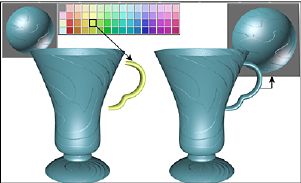
When you attach an object, the materials of the two objects are combined in
the following way:
■If the object being attached does not have a material assigned, it inherits
the material of the object it is being attached to.
Handle inherits material from the cup it is being attached to.
■Likewise, if the object you're attaching to doesn't have a material, it inherits
the material of the object being attached.
■If both objects have materials, the resulting new material is a
multi/sub-object material on page 5558 that encompasses the input materials.
A dialog appears offering three methods of combining the objects' materials
and material IDs. For more information, see Attach Options Dialog on
page 2031 .
Edit Geometry Rollout (Mesh) | 2021
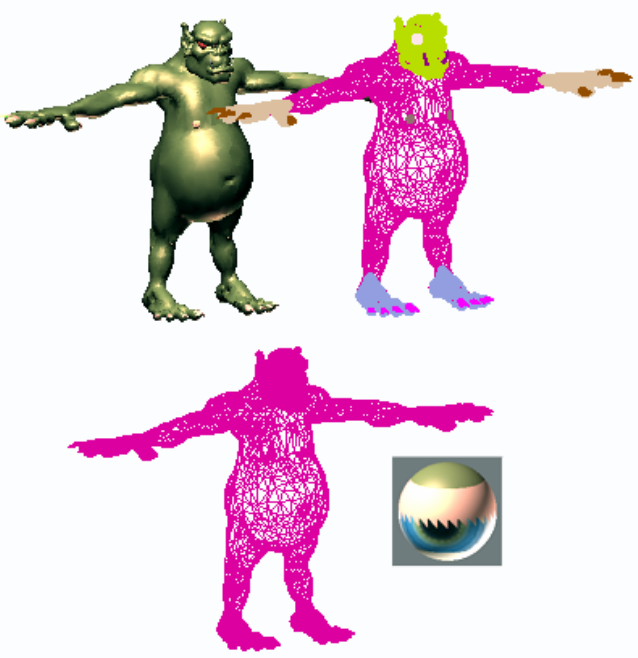
Shaded view of model (upper left); wireframe view of model (upper right); model
with objects attached (lower left); and subsequent multi/sub-object material (lower
right)
Attach remains active in all sub-object levels, but always applies to objects.
Attach List (Object level only) Lets you attach other objects in the scene to
the selected mesh. Click to open the Attach List dialog, which works like
Select From Scene on page 168 to let you choose multiple objects to attach.
Detach (Vertex and Face/Polygon/Element levels only) Detaches the selected
sub-object as a separate object or element. All faces attached to the sub-object
are detached as well.
2022 | Chapter 10 Surface Modeling
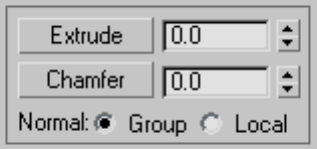
A dialog appears, prompting you to enter a name for the new object. The
dialog has a Detach As Clone option that copies the faces rather than moving
them.
Detached faces leave a hole in the original object when you move them to a
new position.
Break (Vertex level only) Creates a new vertex for each face attached to
selected vertices, allowing the face corners to be moved away from each other
where they were once joined at the original vertex. If a vertex is isolated or
used by only one face, it is unaffected.
Turn (Edge level only) Rotates the edge within its bounding. All mesh objects
in 3ds Max are composed of triangular faces, but by default, most polygons
are depicted as quadrilaterals, with a hidden edge dividing each quad into
two triangles. Turn lets you change the direction in which the hidden edge
(or any other) runs, thus affecting how the shape changes when you transform
sub-objects directly, or indirectly with a modifier.
Divide (Face/Polygon/Element levels only) Subdivides faces into three smaller
faces. This function applies to faces even if you're at the Polygon or Element
sub-object level. Click Divide, and then select a face to be divided. Each face
is subdivided where you click it. You can click as many faces as you want
divided, in sequence. To stop dividing, click Divide again to turn it off, or
right-click.
Extrude, Chamfer, and Bevel group
The Extrude controls let you extrude edges or faces. Edge extrusion works in
a fashion similar to face extrusion. You can apply extrusion interactively (by
dragging on sub-objects) or numerically (using spinners).
Edit Geometry Rollout (Mesh) | 2023
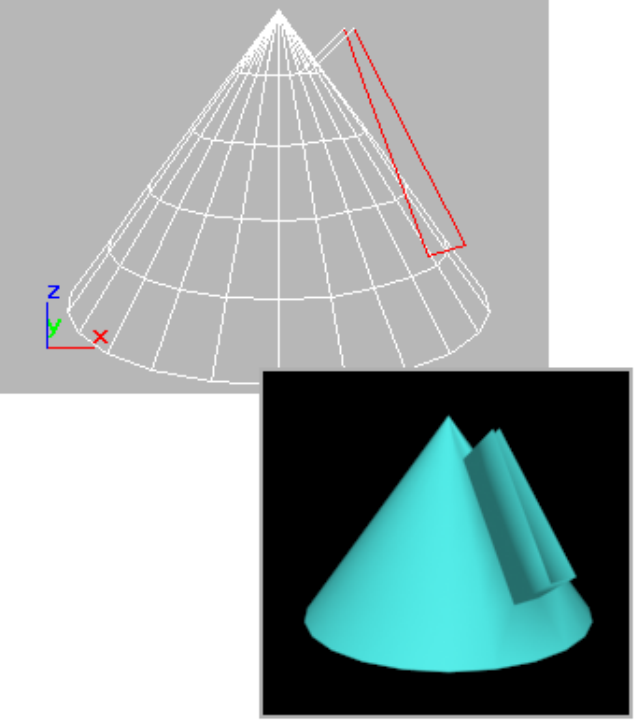
Extruded edges seen in viewport and rendered image
Extrude (Edge and Face/Polygon/Element levels only) Click this button and
then either drag to extrude the selected edges or faces, or adjust the Extrude
spinner to perform the extrusion. You can select different sub-objects to extrude
while Extrude is active.
■Extrude Amount This spinner (to the right of the Extrude button) lets
you specify the amount to extrude the edge. Select one or more edges, and
then adjust the spinner.
2024 | Chapter 10 Surface Modeling
The Chamfer controls are available only at the Vertex and Edge sub-object
levels. They let you bevel object corners using a chamfer function. You can
apply this effect interactively (by dragging vertices) or numerically (using the
Chamfer spinner).
Chamfer (Vertex and Edge levels only) Click this button, and then drag
vertices or edges in the active object. The Chamfer Amount spinner updates
to indicate the chamfer amount as you drag.
If you drag one or more selected vertices or edges, all selected sub-objects are
chamfered identically. If you drag an unselected vertex or edge, any selected
sub-objects are first deselected.
A chamfer "chops off" the selected sub-objects, creating a new face connecting
new points on all visible edges leading to the original sub-object. Chamfer
Amount specifies the exact distance from the original vertex along each of
these edges. New chamfer faces are created with the material ID of one of the
neighboring faces (picked at random) and a smoothing group that is an
intersection of all neighboring smoothing groups.
For example, if you chamfer one corner of a box, the single corner vertex is
replaced by three vertices moving along the three visible edges that lead to
the corner. The software rearranges and splits the adjacent faces to use these
three new vertices, and creates a new triangle at the corner.
■Chamfer Amount Adjust this spinner (to the right of the Chamfer button)
to apply a chamfer effect to selected vertices.
■Normal (Edge and Face/Polygon/Element levels only) Determines how
a selection of more than one edge is extruded. With Normal set to Group
(the default), extrusion takes place along the averaged normal of each
continuous group (line) of edges. If you extrude multiples of such groups,
each group moves along its own averaged normal. If you set Normal to
Local, extrusion takes place along each selected edge's normal.
Beveling, available only at the Face/Polygon/Element levels, is a second step
to extrusion: it lets you scale the faces you have just extruded.
Edit Geometry Rollout (Mesh) | 2025
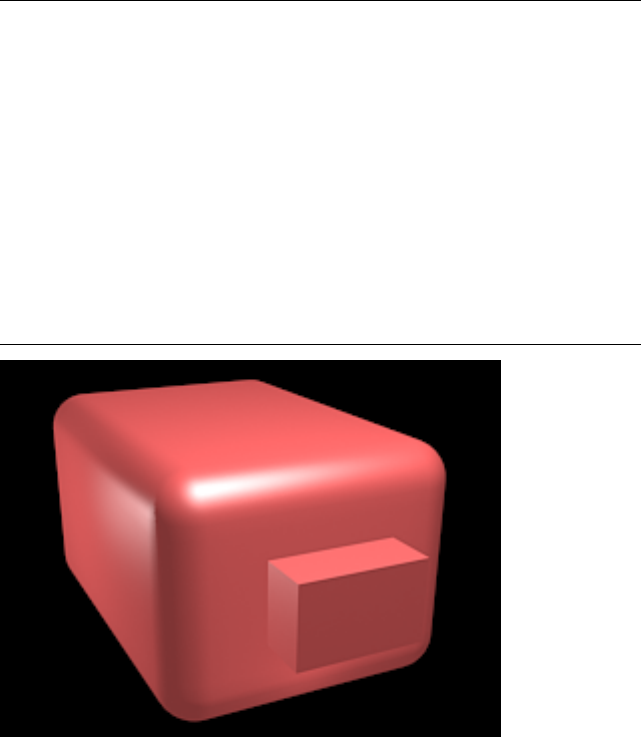
TIP A similar operation is Inset on page 2097 , which Editable Poly has but Editable
Mesh doesn't. When you inset a polygon, you create another, smaller polygon of
the same proportions inside the borders of an original polygon, in the plane of
the original. Essentially, it's a bevel with no height. You can achieve this in Editable
Mesh with the following procedure:
1Select the polygon to inset.
2Right-click the spinner all the way to the right of the Extrude button.
This performs an extrusion with no height, thus creating a new polygon
plus connecting polygons in the same position as the original.
3Set a negative Bevel value using the numeric field or the spinner. This
insets the new polygon created by the extrusion without changing its
height.
Chamfer box showing extruded face
2026 | Chapter 10 Surface Modeling
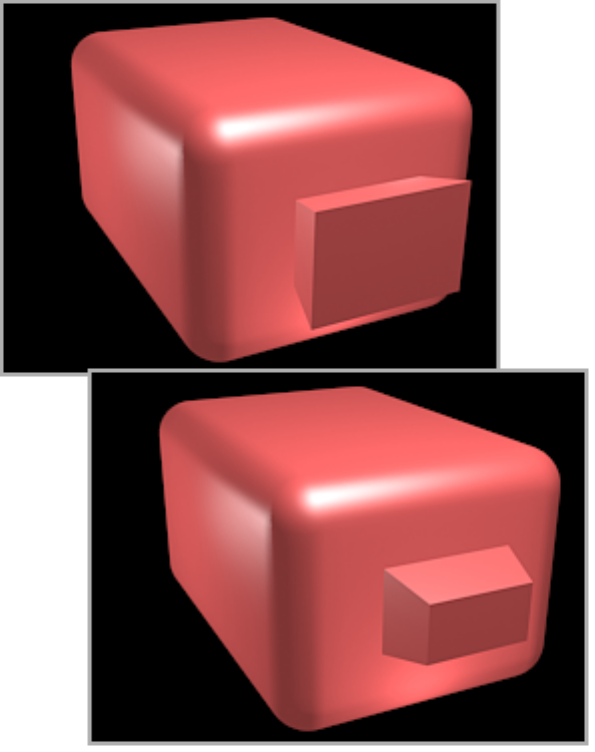
Extruded face beveled in two different directions
You can bevel faces by dragging or by using keyboard/spinner entry.
Bevel (Face/Polygon/Element levels only) Click this button, and then drag
vertically on any face to extrude it. Release the mouse button and move the
mouse vertically to bevel the extrusion. Click to finish.
■When over a selected face, the mouse cursor changes to a Bevel cursor.
Edit Geometry Rollout (Mesh) | 2027
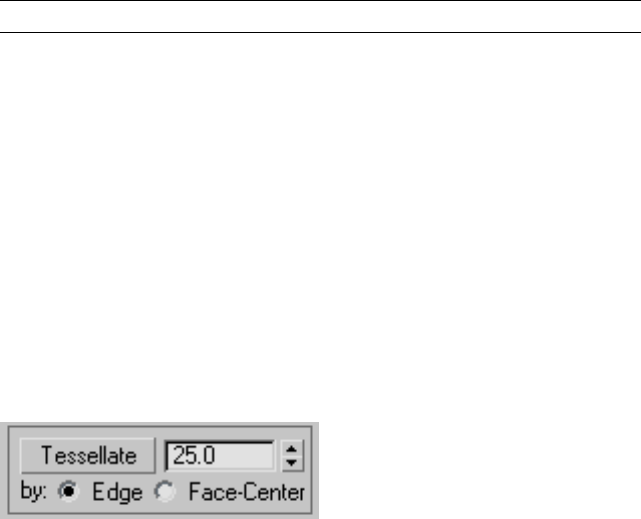
■With multiple faces selected, dragging on any one bevels all selected faces
equally.
■You can drag other faces in turn to bevel them while the Bevel button is
active. Click Bevel again or right-click to end the operation.
Outlining This spinner (to the right of the Bevel button) lets you scale selected
faces bigger or smaller, depending on whether the value is positive or negative.
It is normally used after an extrusion for beveling the extruded faces.
Cut and Slice group
Lets you subdivide edges with either cut or slice tools to create new vertices,
edges, and faces. For details, see Cut and Slice on page 2033 .
NOTE At the Vertex sub-object level, Slice is available but Cut is not.
Weld group (Vertex level only)
Selected Welds selected vertices that fall within the tolerance specified in
the Weld Threshold spinner (to the button's right). All line segments become
connected to the resulting single vertex.
Target Enters weld mode, which allows you to select vertices and move them
around. While moving, the cursor changes to the Move cursor as usual, but
when you position the cursor over an unselected vertex the cursor changes
to a + cursor. Release the mouse at that point to weld all selected vertices to
the target vertex they were dropped on.
The pixels spinner to the right of the Target button sets the maximum distance
in screen pixels between the mouse cursor and the target vertex.
Tessellate group (Face/Polygon/Element levels only)
Use these controls to tessellate (subdivide) selected faces. Tessellation is useful
for increasing local mesh density while modeling. You can subdivide any
selection of faces. Two tessellation methods are available: Edge and Face-Center.
Tessellate Click to tessellate selected faces, based on the Edge, Face-Center,
and Tension (spinner) settings.
2028 | Chapter 10 Surface Modeling
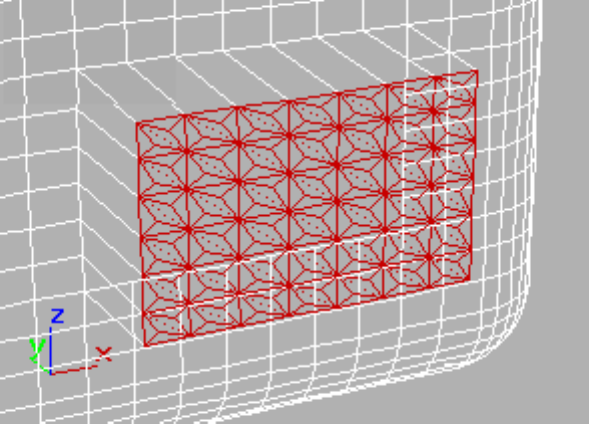
Top: Original selection
Middle: Tessellated once
Bottom: Tessellated twice
Tension (Active only when Tessellate by Edge is active.) This spinner, to the
right of the Tessellate button, lets you increase or decrease the Edge tension
value. A negative value pulls vertices inward from their plane, resulting in a
concave effect. A positive value pulls vertices outward from their plane,
resulting in a rounding effect.
By Edge/Face-Center Edge inserts vertices in the middle of each edge and
draws three lines connecting those vertices. As a result, four faces are created
out of one face. (To see this at the Polygon or Element sub-object level, turn
off Display panel > Display Properties rollout > Edges Only.)
Face-Center adds a vertex to the center of each face and draws three connecting
lines from that vertex to the three original vertices. As a result, three faces are
created out of one face.
Set of polygons showing Face-Center tessellation
Edit Geometry Rollout (Mesh) | 2029
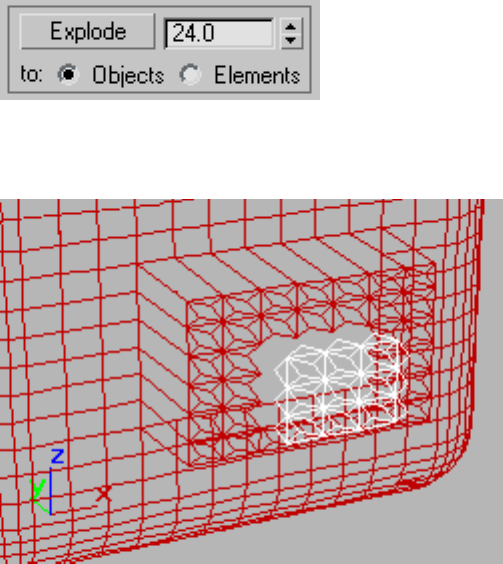
Explode group (Object and Face/Polygon/Element levels only)
Explode Breaks up the current object into multiple elements or objects based
on the angles of its edges. This function is available in Object mode as well
as all sub-object levels except Vertex and Edge.
Exploded faces (white) removed from tessellated faces
The angle threshold spinner, to the right of the Explode button, lets you
specify the angle between faces below which separation will not occur. For
example, all sides of a box are at 90-degree angles to each other. If you set the
spinner to 90 or above, exploding the box changes nothing. However, at any
setting below 90, the sides all become separate objects or elements.
To Objects/Elements Specifies whether the exploded faces become the
separate objects or elements of the current object.
Remove Isolated Vertices Deletes all isolated vertices in the object regardless
of the current selection.
Select Open Edges (Edge level only) Selects all edges with only one face. In
most objects, this shows you where missing faces exist.
2030 | Chapter 10 Surface Modeling
Create Shape from Edges (Edge level only) After selecting one or more edges,
click this button to create a spline shape from the selected edges. A Create
Shape dialog appears, letting you name the shape, set it to Smooth or Linear,
and ignore hidden edges. The new shape's pivot is placed at the center of the
mesh object.
View Align Aligns all vertices in selected objects or sub-objects to the plane
of the active viewport. If a sub-object level is active, this function affects only
selected vertices or those belonging to selected sub-objects.
In the case of orthographic viewports on page 7877 , using View Align has the
same effect as aligning to the construction grid when the home grid is active.
When aligning to a perspective viewport (including camera and light views),
the vertices are reoriented to be aligned to a plane that is parallel to the
camera’s viewing plane. This plane is perpendicular to the view direction that
is closest to the vertices’ average position.
Grid Align Aligns all vertices in selected objects or sub-objects to the plane
of the current view. If a sub-object level is active, function aligns only selected
sub-objects.
This function aligns the selected vertices to the current construction plane.
The current plane is specified by the active viewport in the case of the home
grid. When using a grid object, the current plane is the active grid object.
Make Planar (sub-object levels only) Forces all selected sub-objects to become
coplanar. The plane's normal is the average surface normal of all faces attached
to the selected sub-objects.
Collapse (sub-object levels only) Collapses selected sub-objects into an
averaged vertex.
Attach Options Dialog
Select an editable mesh object. > Modify panel > Attach button
The Attach Options dialog appears when you attach two or more objects to
which materials have been assigned. It provides three different methods of
combining the sub-materials and the material IDs in the two objects.
Attach Options Dialog | 2031
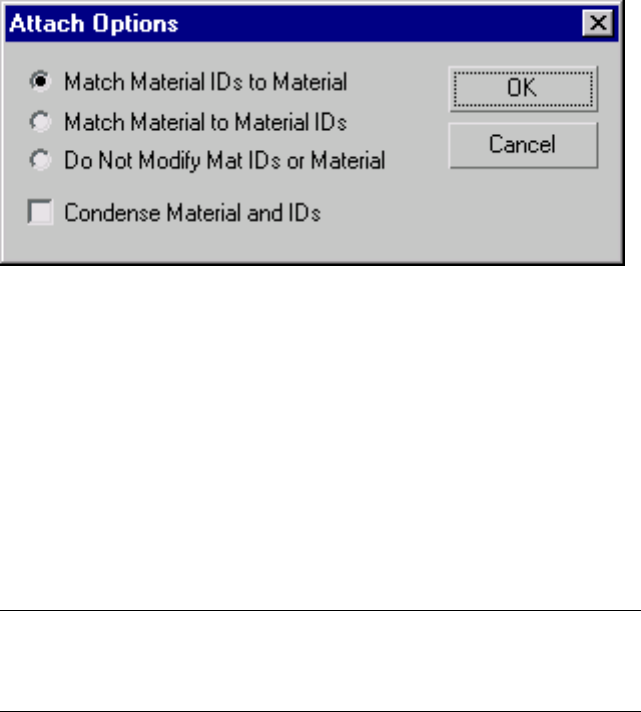
Interface
Match Material IDs to Material The number of material IDs in the attached
objects are modified so they are no greater than the number of sub-materials
assigned to those objects. For example, if you have a box with only two
sub-materials assigned to it, and you attach it to another object, the box will
have only two material IDs, instead of the six it was assigned on creation.
Match Material to Material IDs Maintains the original ID assignment in the
attached objects by adjusting the number of sub-materials in the resulting
multi/sub-object material. For example, if you attach two boxes, both assigned
single materials, but with their default assignment of 6 material IDs, the result
would be a multi/sub-object material with 12 sub-materials (six containing
instances of one box's material, and six containing instances of the other box's
material). Use this option when it's important to maintain the original material
ID assignments in your geometry.
NOTE If you want to make the instanced sub-materials unique, select them in
Track View, and click the Make Unique button on the Track View toolbar. You can
also make them unique one at a time with the Make Unique button on page 5250
in the Material Editor.
Do Not Modify Mat IDs or Material Does not adjust the number of
sub-materials in the resulting sub-object material. Note that, if the number of
material IDs in an object is greater than the number of sub-materials in its
multi/sub-object material, then the resulting face-material assignment might
be different after the attach.
Condense Material IDs Affects the Match Material IDs To Material option.
When this is on, duplicate sub-materials or sub-materials that aren't used in
the objects are removed from the multi/sub-object material that results from
the attach operation. Default=on.
2032 | Chapter 10 Surface Modeling

Tips
■In most cases, use the first option (Match Material IDs to Material) while
keeping Condense Material IDs selected. This maintains the appearance
of the objects, and results in the fewest additional sub-materials or IDs.
■Use the second option (Match Material to Material IDs) when you need
to maintain the original material ID assignments.
■Avoid using the third option, unless you need to repeat a 3ds Max version
1 attachment for compatibility with a previous project.
■Leave Condense Material IDs selected unless you have an unassigned
sub-material that you want to keep for future assignment.
■Perform Edit menu > Hold before performing the attach.
Cut and Slice
Select an editable mesh object. > Modify panel > Selection rollout > (Optional:
Choose a sub-object level.) > Edit Geometry rollout > Cut and Slice group box
The tools available in the Cut and Slice group let you subdivide edges and
faces to create new vertices, edges, and faces. You can slice an editable mesh
object at any sub-object level; the Cut tool is available at every sub-object level
except the Vertex sub-object level.
Procedures
To create a new face using Cut:
1Convert the geometry to an editable mesh.
2 On the Modify panel, choose the object's Edge (or Face, Polygon,
or Element) sub-object level.
3On the Selection rollout, turn on Ignore Backfacing.
4On the Edit Geometry rollout, in the Cut and Slice group, click the Cut
button.
5Click the first edge you want to subdivide, and then move your cursor
toward the second edge. The cursor changes to a plus sign when over an
Cut and Slice | 2033
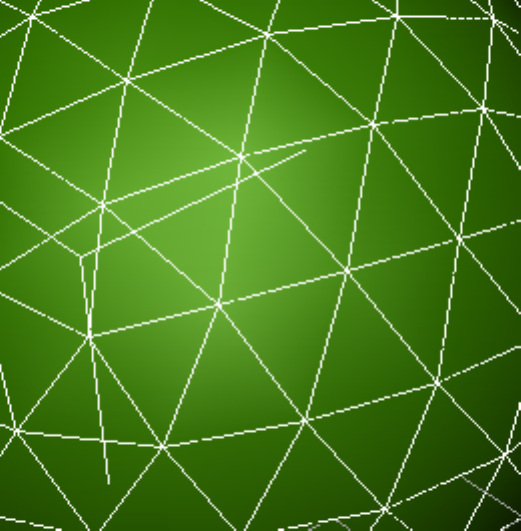
edge, and a dotted line connects the initial point where the edge was
clicked with the current cursor location.
6Click the second edge. This edge can be anywhere, cutting across as many
faces as you like. A new visible edge appears.
7At this point, a new dotted line is connected to the mouse cursor,
originating from the last point you clicked.
8Continue clicking edges to cut. To start from a different point, right-click,
and then select the new start point. To finish cutting, right-click twice.
You can use Snaps on page 2568 with Cut. To divide an edge in half, set
Snaps to midpoint. To start or end a cut at a vertex, set snap to vertex or
endpoint.
2034 | Chapter 10 Surface Modeling
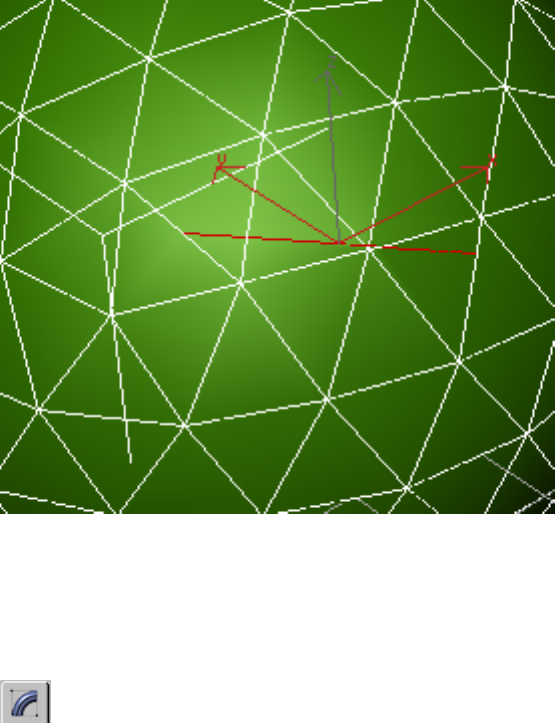
Before and after applying Cut to faces
To create multiple slices:
1Select an editable mesh.
2 On the Modify panel, choose the object's Edge (or Face, Polygon,
or Element) sub-object level.
3Select one or more sub-objects. Slice affects only selected sub-objects.
4In the Cut And Slice group box, click the Slice Plane button.
5Position and rotate the Slice Plane gizmo to where you want the first
slice.
6Click the Slice button. The object is sliced.
7If you want, move the Slice Plane to a second position and click the Slice
button again.
Cut and Slice | 2035
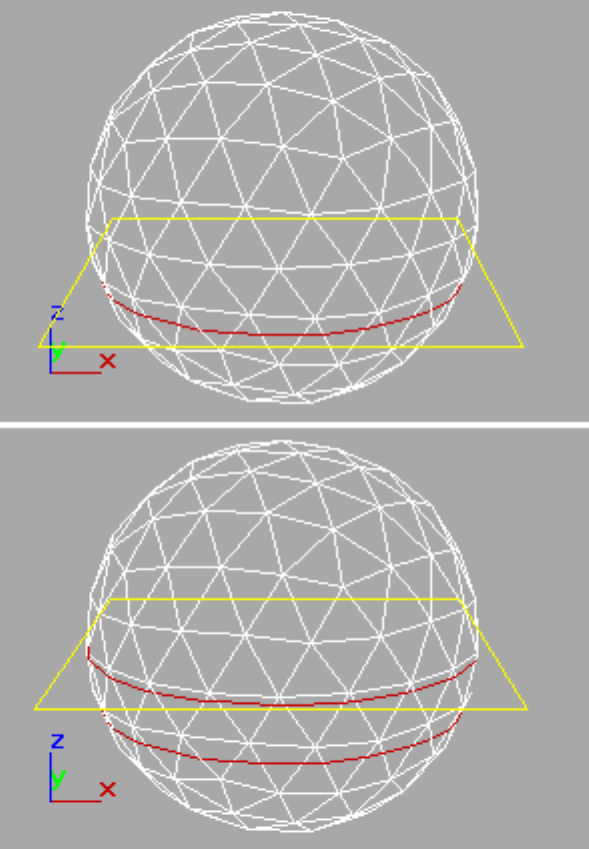
8Click the Slice Plane button again to turn it off and see the results.
9To better understand what has happened, turn off Edges Only in the
Display panel.
Slice gizmo placed for first slice (top) and second slice (bottom)
2036 | Chapter 10 Surface Modeling
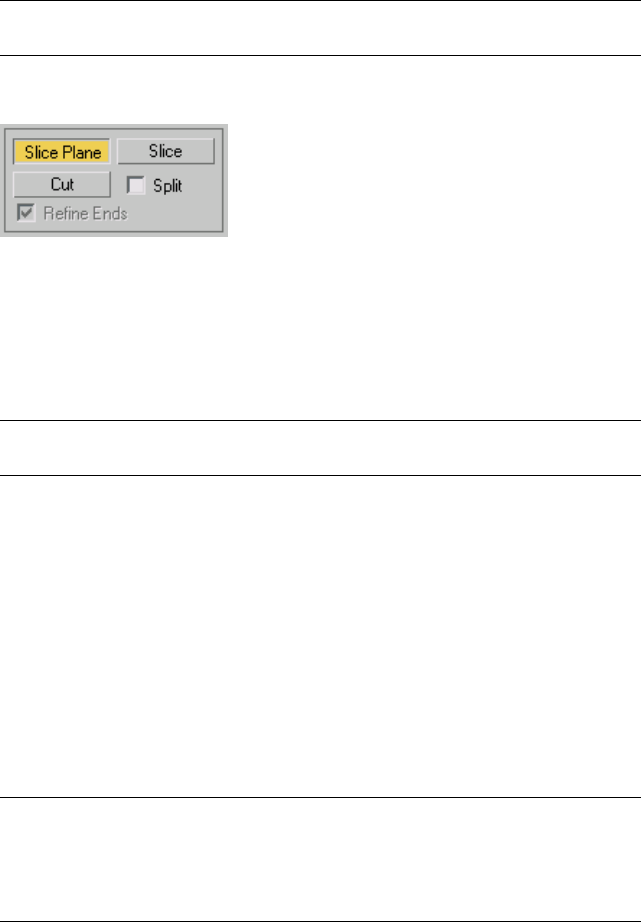
Interface
NOTE The keyboard shortcuts listed here require that the Keyboard Shortcut
Override Toggle on page 7646 be on.
Cut and Slice group
Slice Plane Creates a gizmo for a slice plane that can be positioned and
rotated where you want to slice the edges. Also enables the Slice button.
Slice Performs the slice operation at the location of the slice plane. The Slice
button is available only when the Slice Plane button is highlighted. This tool
slices the mesh just like the Slice modifier on page 1658 in “Operate On: Face”
mode.
NOTE Slice works only on a sub-object selection. Make the selection before
activating Slice Plane.
Cut Lets you divide a edge at any point, then divide a second edge at any
point, creating a new edge or edges between the two points. Clicking the first
edge sets the first vertex. A dotted line tracks the cursor movement until you
click a second edge. A new vertex is created at each edge division. Alternately,
double-clicking an edge simply divides that edge at the point clicked, with
invisible edges on either side.
You can use Cut to cut across any number of faces, even across an entire object.
Click one edge to start the cut, and a second edge to end the cut.
Use Snaps on page 2568 with Cut for precision. Cut supports Midpoint,
Endpoint, and Vertex snaps.
You can also use the keyboard shortcut Alt+C to toggle Cut mode.
IMPORTANT When using the Cut tool to add new edges, you should work in a
non-Perspective viewport, such as Front or User. If you use Cut while working in
a Perspective viewport, you may find that the created edges appear to jump or
aren't placed correctly. Using an orthogonal viewport will allow the cuts to appear
where you click.
Cut and Slice | 2037
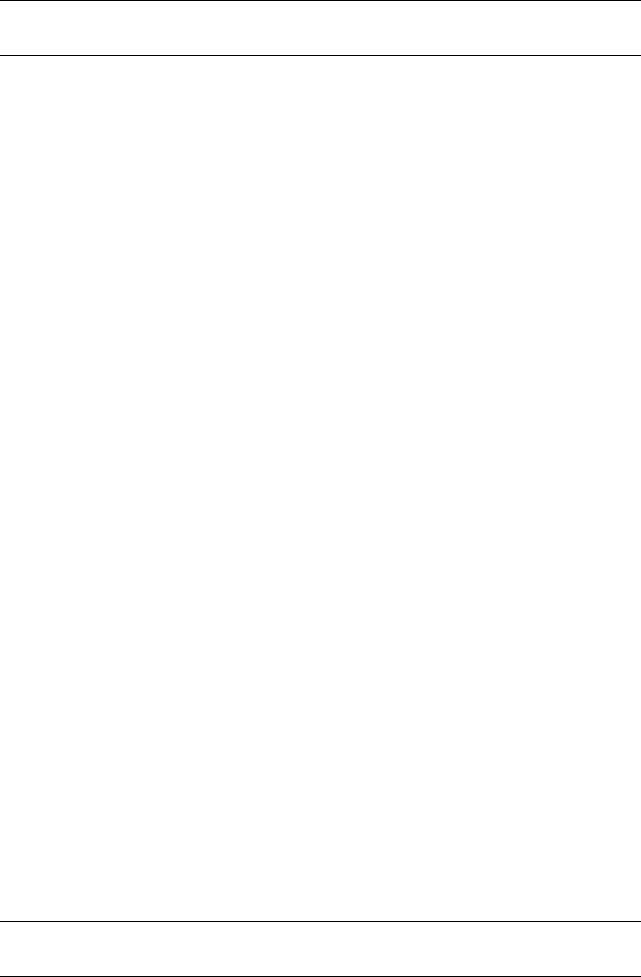
TIP When performing a Cut, turn on Selection rollout > Ignore Backfacing to avoid
accidentally selecting edges on the back side of the mesh.
Split When on, the Slice and Cut operations create double sets of vertices
at the points where the edges are divided. This lets you easily delete the new
faces to create holes, or animate the new faces as separate elements.
Refine Ends When on, adjacent faces at the ends of the cut are also divided
by additional vertices, so that the surface stays contiguous. When Refine Ends
is off, the surface will have a seam where the new vertex meets the adjacent
face. For this reason, it’s a good idea to keep Refine Ends turned on, unless
you are sure that you don’t want the extra vertices created.
Refine Ends affects only Cut. It does not affect Slice.
Editable Poly Surface
Create or select an object. > Quad menu > Transform quadrant > Convert To
submenu > Convert to Editable Poly
Create or select an object. > Modify panel > Right-click the base object in the
stack. > Choose Convert to: Editable Poly.
Editable Poly on page 7765 is an editable object with five sub-object levels:
vertex, edge, border, polygon, and element. Its usage is similar to that of an
editable mesh object on page 1990 , with controls for manipulating an object
as a polygon mesh at various sub-object levels. Rather than triangular faces,
however, the poly object's faces are polygons with any number of vertices.
Editable Poly gives you these options:
■Transform or Shift+Clone the selection, as with any object.
■Use the options supplied on the Edit rollouts to modify the selection or
object. Later topics discuss these options for each of the polymesh
components.
■Pass a sub-object selection to a modifier higher in the stack. You can apply
one or more standard modifiers to the selection.
■Use the options on the Interface on page 2119 to alter surface characteristics.
TIP You can exit most Editable Poly command modes, such as Extrude, by
right-clicking in the active viewport.
2038 | Chapter 10 Surface Modeling
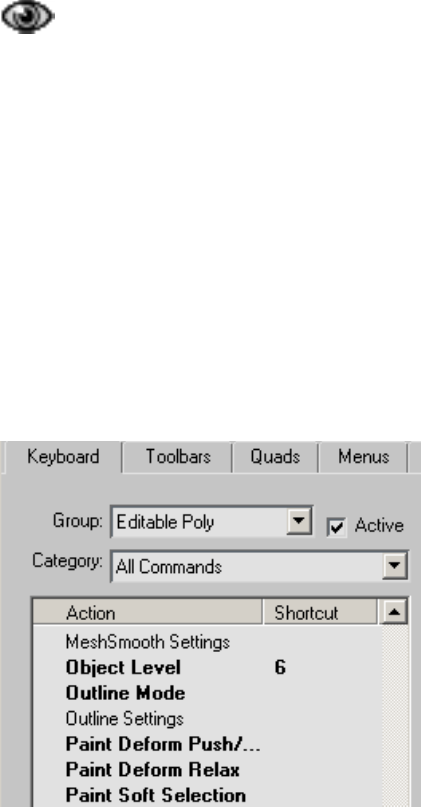
Overriding Actions with Press/Release Keyboard Shortcuts
While working with editable poly objects, you can use a “press/release keyboard
shortcut” to temporarily override the current operation and perform a different
one. As soon as you release the keyboard shortcut, you return to the previous
operation.
For example, you might be working at the Polygon sub-object level, moving
polygons, and need to rotate the object to access a different part of it. Instead
of having to exit the Polygon sub-object level, rotate the object and then
re-enter the sub-object level, you could simply press and hold 6, rotate the
object, release the key, and immediately return to moving polygons.
To see a list of press/release keyboard shortcuts for Editable Poly, go to
Customize > Customize User Interface > Keyboard panel, open the Group
drop-down list, and choose Editable Poly. The actions in boldface are the ones
that you can assign as press/release shortcuts. Not all are assigned; for
information about assigning keyboard shortcuts, see Keyboard Panel on page
7489 .
The actions in boldface can function as press/release shortcuts.
Editable Poly Workflow
Sub-object-specific functions, such as Remove on page 2076 for edges, appear
on their own rollouts in the Editable Poly user interface. This leaves the Edit
Editable Poly Surface | 2039
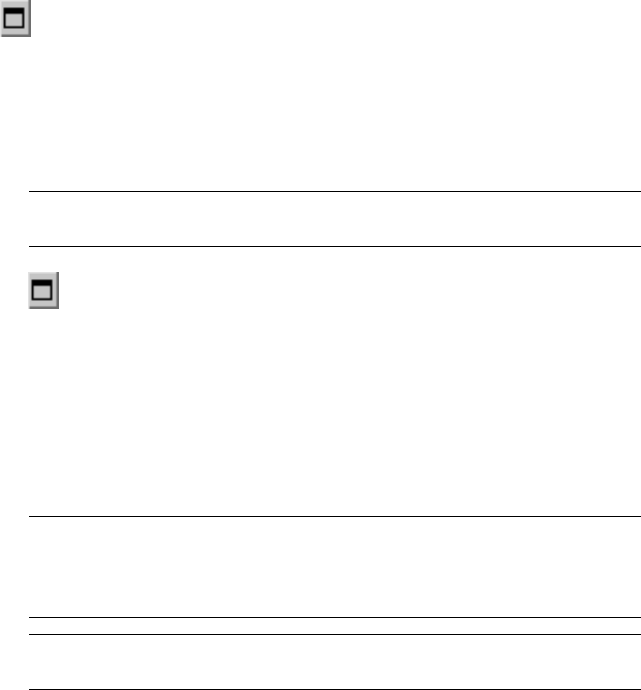
Geometry rollout on page 2105 with functions that you can apply at most
sub-object levels, as well as at the object level.
Also, many commands are accompanied by a Settings button, which gives
you a second way to use the command:
■In Direct Manipulation mode, activated by clicking the command button,
you apply the command by manipulating sub-objects directly in the
viewport. An example of this is Extrude: You click the Extrude button, and
then click and drag sub-objects in the viewports to extrude them.
NOTE Some buttons, such as Tessellate, operate on the mesh immediately,
with no viewport manipulation required.
■ Interactive Manipulation mode is well suited to experimentation. You
activate this mode by clicking the command's Settings button. This opens
a non-modal settings dialog and places you in preview mode, where you
can set parameters and see the results immediately in the viewport on the
current sub-object selection. You can then accept the results by clicking
OK, or reject them by clicking Cancel. You can also use this mode to apply
the same or different settings to several different sub-object selections in
a row. Make the selection, optionally change the settings, click Apply, and
then repeat with a different selection.
IMPORTANT When you click Apply, the settings are “baked into” the selection,
and then applied again to the selection as a preview. If you then click OK to
exit, you will have applied the settings twice. If your intention is to apply them
only once, simply click OK the first time, or click Apply, and then Cancel.
NOTE Changes implemented in Interactive Manipulation mode cannot be
animated.
See also:
■Edit Poly Modifier on page 1293
■Poly Select Modifier on page 1541
■Turn To Poly Modifier on page 1761
2040 | Chapter 10 Surface Modeling
Procedures
To produce an editable poly object:
First select an object, and then do one of the following:
1If no modifiers are applied to the object, In the Modify panel, right-click
in the modifier stack display and choose Editable Poly from the Convert
To list on the pop-up menu.
2Right-click the object and choose Convert To Editable Poly from the
Convert To submenu in the Transform quadrant of the quad menu.
3Apply a modifier to a parametric object that turns the object into a poly
object in the stack display, and then collapse the stack. For example, you
can apply a Turn To Poly modifier on page 1761 .
To collapse the stack, use the Collapse utility on page 1931 and set Output
Type to Modifier Stack Result, or right-click the object's modifier stack
and then choose Collapse All.
Converting an object to Editable Poly format removes all parametric controls,
including the creation parameters. For example, you can no longer increase
the number of segments in a box, slice a circular primitive, or change the
number of sides on a cylinder. Any modifiers you apply to an object are merged
into the mesh as well. After conversion, the only entry left on the stack is
"Editable Poly."
To maintain an object's creation parameters:
■As noted in the previous procedure, if you convert an existing object to
editable poly format, 3ds Max replaces the creation parameters in the stack
with "Editable Poly." The creation parameters are no longer accessible or
animatable. If you want to maintain the creation parameters, you can use
the Edit Poly modifier on page 1293 or the Turn To Poly modifier on page
1761 .
Interface
Stack Display
For more information on the Stack Display, see Modifier Stack on page 7427 .
Show End Result Normally, if you apply a modifier such as Symmetry on
page 1735 to an editable poly object and then return to the Editable Poly stack
entry, you cannot see the effect of the modifier on the object's geometry. But
Editable Poly Surface | 2041
if you turn on Show End Result while in sub-object level, you can see the final
object as a white mesh, the original sub-object selection as a yellow mesh,
and the original editable polymesh as an orange mesh.
Selection rollout
Lets you access the different sub-object levels. See Selection Rollout (Polymesh)
on page 2043 .
Soft Selection rollout
Soft Selection controls apply a smooth falloff between selected sub-objects
and unselected ones. When Use Soft Selection is on, unselected sub-objects
near your selection are given partial selection values. These values are shown
in the viewports by means of a color gradient on the vertices, and optionally
on the faces. They affect most types of sub-object deformations, such as the
Move, Rotate, and Scale functions and any deformation modifiers (such as
Bend) applied to the object. This provides a magnet-like effect with a sphere
of influence around the selection.
For more information, see Soft Selection Rollout on page 1926 .
Edit (sub-object) rollout
The Edit (sub-object) rollout provides sub-object-specific functions for editing
an editable poly object and its sub-objects. For specific information, click any
of the links below:
Edit Vertices rollout on page 2058
Edit Edges rollout on page 2075
Edit Borders rollout on page 2086
Edit Polygons/Elements rollout on page 2092
Edit Geometry rollout
The Edit Geometry rollout provides global functions for editing an editable
poly object and its sub-objects. For specific information, click any of the links
below:
Editable Poly (Object) on page 2054
Editable Poly (Vertex) on page 2064
Editable Poly (Edge) on page 2084
2042 | Chapter 10 Surface Modeling
Editable Poly (Border) on page 2090
Editable Poly (Polygon/Element) on page 2102
Subdivision Surface rollout
Controls on this rollout apply subdivision to the polymesh in the style of the
MeshSmooth modifier. See Subdivision Surface Rollout (Polymesh) on page
2118 .
Subdivision Displacement rollout
Specifies surface approximation for subdividing the polymesh. See Subdivision
Displacement Rollout (Polymesh) on page 2123 .
Subdivision Presets group & Subdivision Method group
The controls in these two group boxes specify how the program applies the
displacement map when Subdivision Displacement is on. They are identical
to the Surface Approximation controls on page 2469 used for NURBS surfaces.
Paint Deformation rollout
Paint Deformation lets you stroke elevated and indented areas directly onto
object surfaces. For more information, see Paint Deformation Rollout on page
2125 .
Selection Rollout (Polymesh)
Create or select an editable poly object. > Modify panel > Selection rollout
The Selection rollout provides tools for accessing different sub-object levels
and display settings and for creating and modifying selections, and displays
information about selected entities.
When you first access the Modify panel with an editable poly selected, you're
at the Object level, with access to several functions available as described in
Editable Poly (Object) on page 2053 . You can toggle the various sub-object
levels, and access relevant functions, by clicking the buttons at the top of the
Selection rollout.
Clicking a button here is the same as choosing a sub-object type in the modifier
stack display. Click the button again to turn it off and return to the Object
selection level.
Selection Rollout (Polymesh) | 2043
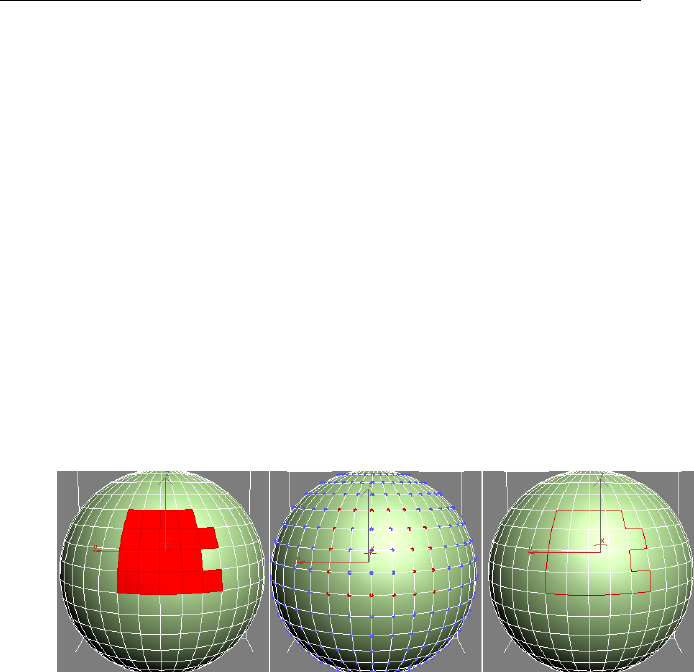
NOTE You can convert sub-object selections in three different ways with the use
of the Ctrl and Shift keys:
■To convert the current selection to a different sub-object level, clicking a
sub-object button on the Selection rollout with Ctrl held down. This selects
all sub-objects at the new level that touch the previous selection. For
example, if you select a vertex, and then Ctrl+click the Polygon button, all
polygons that use that vertex are selected.
■To convert the selection to only sub-objects all of whose source components
are originally selected, hold down both Ctrl and Shift as you change the
level. For example, if you convert a vertex selection to a polygon selection
with Ctrl+Shift+click, the resultant selection includes only those polygons
all of whose vertices were originally selected.
■To convert the selection to only sub-objects that border the selection, hold
down Shift as you change the level. The selection conversion is inclusive,
meaning:
■When you convert faces, the resulting selection of edges or vertices all
belong to selected faces that bordered unselected faces. Only the edges
or vertices that bordered unselected faces are selected.
Face selection (left) converted to vertex border (center) and edge border (right)
■When you convert vertices to faces, the resulting selection of faces had
all of their vertices selected and bordered unselected faces. When you
convert vertices to edges, the resulting selection contains only edges
all of whose vertices were previously selected and only edges of faces
that did not have all vertices selected; that is, of faces around the border
of the vertex selection.
2044 | Chapter 10 Surface Modeling
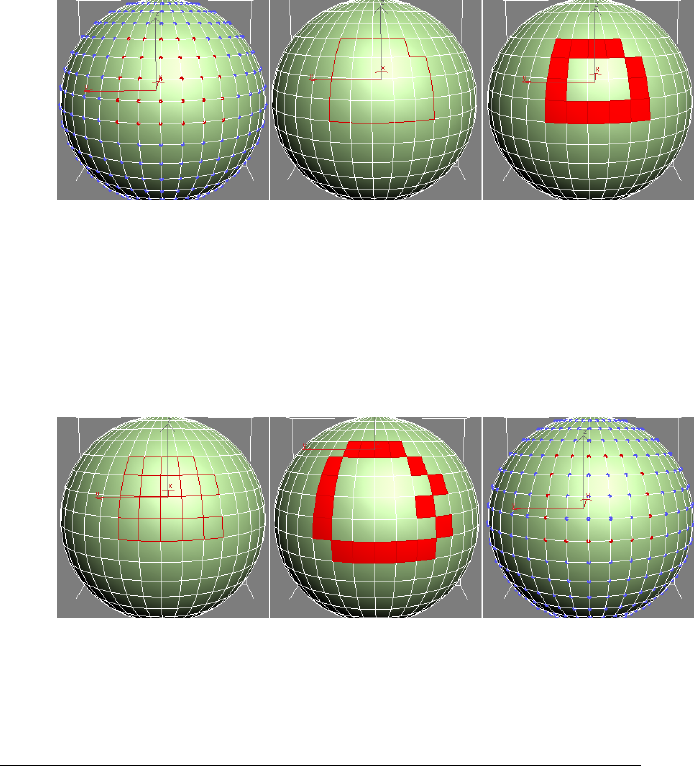
Vertex selection (left) converted to edge border (center) and face border (right)
■When you convert edges to faces, the resulting selection of faces had
some but not all of their edges selected, and were next to faces with no
edges selected. When you convert edges to vertices, the resulting vertices
are on previously selected edges, but only at intersections where not
all edges were selected.
Edge selection (left) converted to face border (center) and vertex border (right)
Conversion commands are also available from the quad menu.
Selection Rollout (Polymesh) | 2045

Interface
Vertex Turns on Vertex sub-object level, which lets you select a vertex
beneath the cursor; region selection selects vertices within the region.
Edge Turns on Edge sub-object level, which lets you select a polygon
edge beneath the cursor; region selection selects multiple edges within the
region.
Border Turns on Border sub-object level, which lets you select a
sequence of edges that borders a hole in the mesh. Borders are always composed
of edges with faces on only one side of them, and are always complete loops.
For example, a box doesn't have a border, but the teapot object has a couple
of them: on the lid, on the body, on the spout, and two on the handle. If you
create a cylinder, then delete one end, the row of edges around that end forms
a border.
When Border sub-object level is active, you can't select edges that aren't on
borders. Clicking a single edge on a border selects that whole border.
You can cap a borders, either in Editable Poly or by applying the Cap Holes
modifier on page 1159 . You can also connect borders between objects with the
Connect compound object on page 668 .
Polygon Turns on Polygon sub-object level, which lets you select
polygons beneath the cursor. Region selection selects multiple polygons within
the region.
2046 | Chapter 10 Surface Modeling
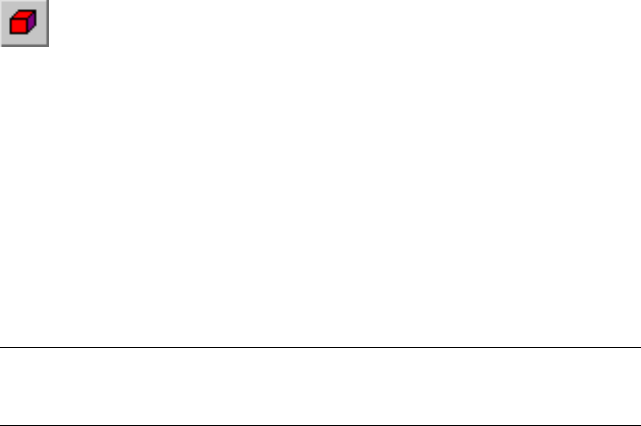
Element Turns on Element sub-object level, which lets you select all
contiguous polygons in an object. Region selection lets you select multiple
elements.
By Vertex When on, you can select sub-objects only by selecting a vertex
that they use. When you click a vertex, all sub-objects that use the selected
vertex are selected.
Ignore Backfacing When on, selection of sub-objects affects only those facing
you. When off (the default), you can select any sub-object(s) under the mouse
cursor, regardless of their visibility or facing. If there are more than one
sub-object under the cursor, repeated clicking cycles through them. Likewise,
with Ignore Backfacing off, region selection includes all sub-objects, regardless
of the direction they face.
NOTE The state of the Backface Cull setting in the Display panel does not affect
sub-object selection. Thus, if Ignore Backfacing is off, you can still select sub-objects,
even if you can't see them.
By Angle When on and you select a polygon, the software also selects
neighboring polygons based on the angle setting to the right of the check
box. This value determines the maximum angle between neighboring polygons
to select. Available only at the Polygon sub-object level.
For example, if you click a side of a box and the angle value is less than 90.0,
only that side is selected, because all sides are at 90-degree angles to each
other. But if the angle value is 90.0 or greater, all sides of the box are selected.
This function speeds up selection of contiguous areas made up of polygons
that are at similar angles to one another. You can select coplanar polygons
with a single click at any angle value.
Shrink Reduces the sub-object selection area by deselecting the outermost
sub-objects. If the selection size can no longer be reduced, the remaining
sub-objects are deselected.
Grow Expands the selection area outward in all available directions.
For this function, a border is considered to be an edge selection.
Selection Rollout (Polymesh) | 2047
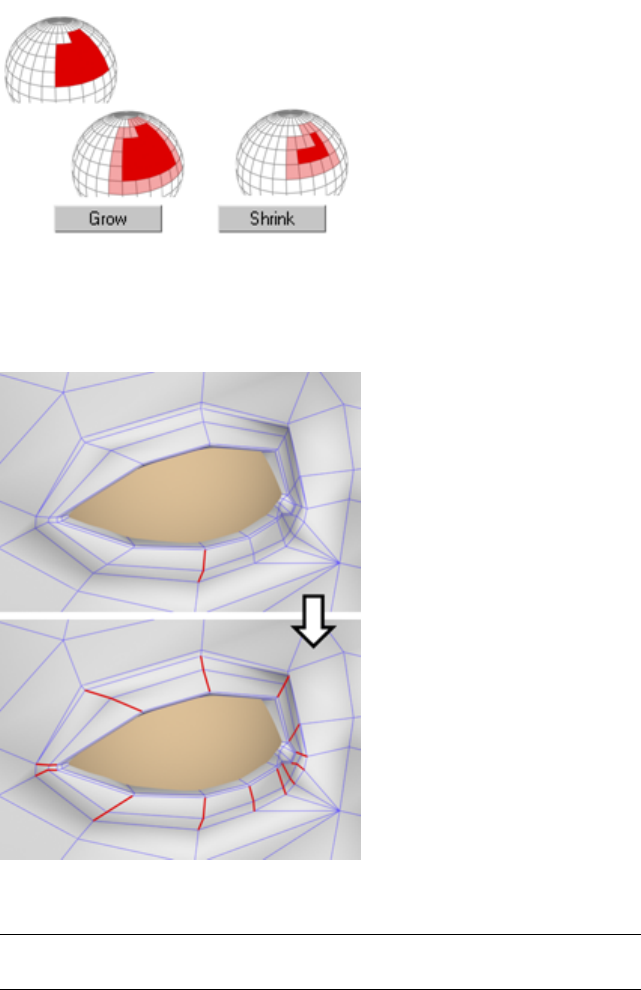
With Shrink and Grow, you can add or remove neighboring elements from the edges
of your current selection. This works at any sub-object level.
Ring Expands an edge selection by selecting all edges parallel to the selected
edges. Ring applies only to edge and border selections.
Ring selection adds to the selection all the edges that are parallel to the ones selected
originally.
TIP After making a ring selection, you can use Connect on page 2080 to subdivide
the associated polygons into new edge loops.
2048 | Chapter 10 Surface Modeling
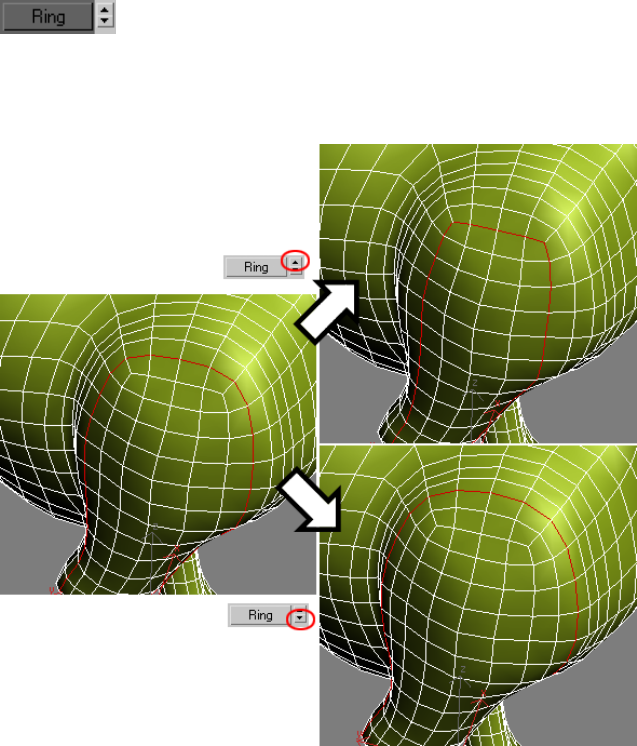
[Ring Shift] The spinner next to the Ring button lets you move
the selection in either direction to other edges in the same ring; that is, to
neighboring, parallel edges. If you have a loop selected, you can use this
function to select a neighboring loop. Applies only to Edge and Border
sub-object levels.
Left: Original loop selection
Upper right: Ring Shift up moves selection outward (from center of model).
Lower right: Ring Shift down moves selection inward (toward center of model).
To expand the selection in the chosen direction, Ctrl+click the up or down
spinner button. To shrink the selection in the chosen direction, Alt+click the
up or down spinner button.
Loop Expands the selection as far as possible, in alignment with selected
edges.
Selection Rollout (Polymesh) | 2049
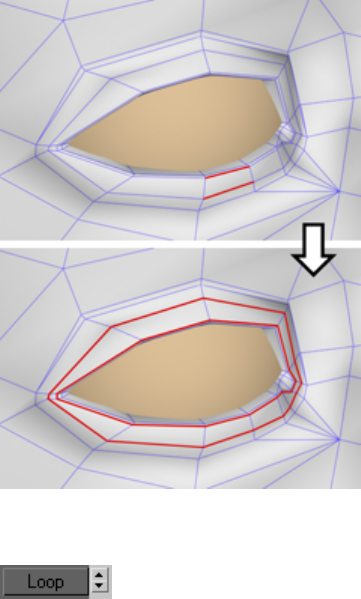
Loop applies only to edge and border selections, and propagates only through
four-way junctions.
Loop selection extends your current edge selection by adding all the edges aligned to
the ones selected originally.
[Loop Shift] The spinner next to the Loop button lets you
move the selection in either direction to other edges in the same loop; that
is, to neighboring, aligned edges. If you have a ring selected, you can use this
function to select a neighboring ring. Applies only to Edge and Border
sub-object levels.
2050 | Chapter 10 Surface Modeling
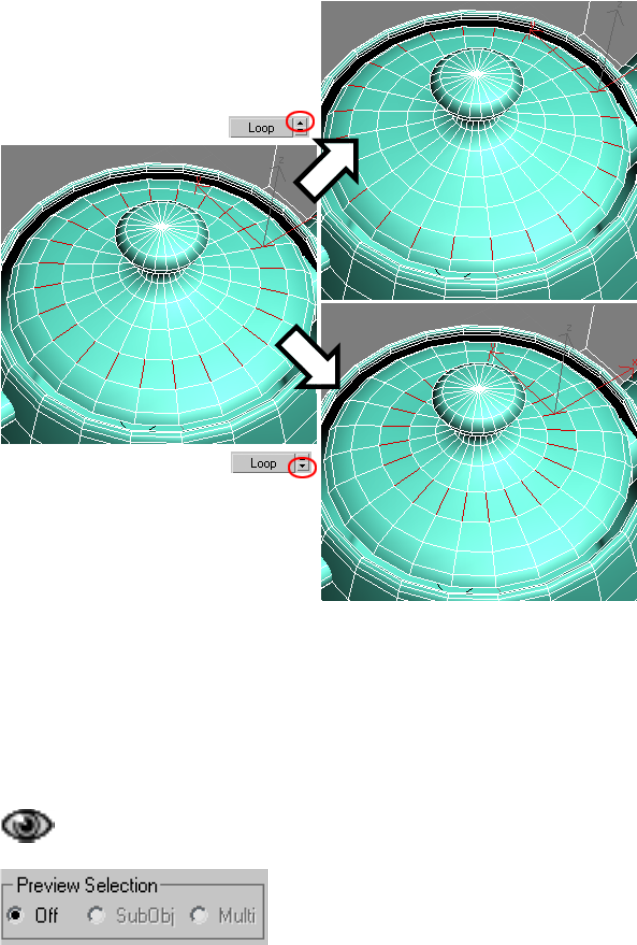
Left: Original ring selection
Upper right: Loop Shift up moves selection outward.
Lower right: Loop Shift down moves selection inward.
To expand the selection in the chosen direction, Ctrl+click the up or down
spinner button. To shrink the selection in the chosen direction, Alt+click the
up or down spinner button.
Preview Selection
Selection Rollout (Polymesh) | 2051
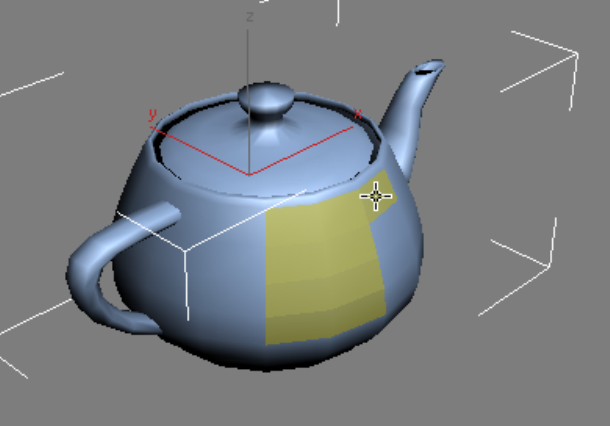
This option lets you preview a sub-object selection before committing to it.
You can preview at the current sub-object level, or switch sub-object levels
automatically based on the mouse position. The choices are:
■Off No preview is available.
■SubObj Enables previewing at the current sub-object level only. As you
move the mouse over the object, the sub-object under the cursor highlights
in yellow. To select the highlighted object, click the mouse.
To select multiple sub-objects at the current level, press and hold Ctrl,
move the mouse to highlight more sub-objects, and then click to select all
highlighted sub-objects.
Polygon sub-object selection preview with Ctrl held down
To deselect multiple sub-objects at the current level, press and hold Ctrl+Alt,
move the mouse to highlight more sub-objects, and then click a selected
sub-object. This deselects all highlighted sub-objects.
■Multi Works like SubObj, but also switches among the Vertex, Edge, and
Polygon sub-object levels on the fly, based on the mouse position. For
example, if you position the mouse over an edge, the edge highlights, and
then clicking activates the Edge sub-object level and selects the edge.
To select multiple sub-objects of the same type, press and hold Ctrl after
highlighting a sub-object, move the mouse to highlight more sub-objects,
2052 | Chapter 10 Surface Modeling
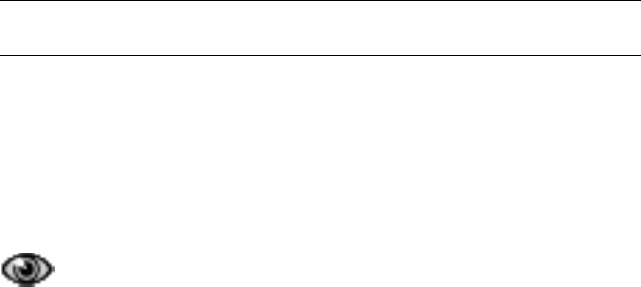
and then click to activate that sub-object level and select all highlighted
sub-objects.
To deselect multiple sub-objects at the current sub-object level, press and hold
Ctrl+Alt, move the mouse to highlight more sub-objects, and then click a
selected sub-object. This deselects all highlighted sub-objects. Note that
this method does not switch sub-object levels.
NOTE When Ignore Backfacing is off, you’ll see backfacing vertices and edges
highlight while previewing a sub-object selection.
Selection Information
At the bottom of the Selection rollout is a text display giving information
about the current selection. If 0 or more than one sub-object is selected, the
text gives the number and type selected; for example, “4 Polygons Selected.”
If one sub-object is selected, the text gives the identification number and type
of the selected item; for example, “Polygon 73 Selected.”
When using Preview Selection on page 2051 , a second line gives
additional information about the identity or number of highlighted
sub-objects.
Editable Poly (Object)
Select an editable poly object. > Modify panel
Select an editable poly object. > Quad menu > Tools 1 quadrant > Top-level
Editable Poly (Object) functions are available when no sub-object levels are
active. These functions are also available at all sub-object levels, and work the
same in each mode, except as noted below.
Use the Selection rollout on page 2046 or modifier stack on page 7427 to access
the different sub-object levels.
Editable Poly (Object) | 2053
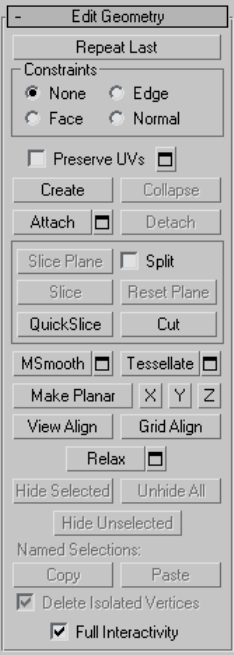
Interface
Edit Geometry rollout
See Edit Geometry Rollout (Polymesh) on page 2105 for detailed descriptions
of these controls.
Subdivision Surface rollout
See Interface on page 2119 for information on the Subdivision Surface rollout
settings.
2054 | Chapter 10 Surface Modeling

Subdivision Displacement rollout
See Interface on page 2124 for information on the Subdivision Displacement
rollout settings.
Paint Deformation rollout
Paint Deformation lets you stroke elevated and indented areas directly onto
object surfaces. For more information, see Paint Deformation Rollout on page
2125 .
Editable Poly (Vertex)
Select an editable poly object. > Modify panel > Selection rollout > Vertex
Select an editable poly object. > Modify panel > Modifier Stack display > Expand
Editable Poly. > Vertex
Select an editable poly object. > Quad menu > Tools 1 quadrant > Vertex
Vertices are points in space: they define the structure of other sub-objects that
make up the poly. When vertices are moved or edited, the geometry they form
is affected as well. Vertices can also exist independently; such isolated vertices
can be used to construct other geometry but are otherwise invisible when
rendering.
At the Editable Poly (Vertex) sub-object level, you can select single and multiple
vertices and move them using standard methods. This topic covers the Edit
Geometry, Edit Vertices, and Vertex Properties rollouts; for other controls, see
Editable Poly on page 2038 .
Procedures
To weld polygon vertices:
You can use either of two methods to combine several vertices into one, also
known as welding. If the vertices are very close together, use the Weld function.
You can also use Weld to combine a number of vertices to the average position
of all of them.
Editable Poly (Vertex) | 2055

Alternatively, to combine two vertices that are far apart, resulting in a single
vertex that's in the same position as one of them, use Target Weld.
1To use Weld:
■On the Selection rollout, turn on Ignore Backfacing, if necessary. This
ensures that you're welding only vertices you can see.
■Select the vertices to weld.
■If the vertices are very close together, simply click Weld. If that doesn't
work, proceed to the next step.
■ Click the Settings button to the right of the Weld button.
This opens the Weld Vertices dialog on page 2150 .
■Increase the Weld Threshold value gradually using the spinner (click
and hold on the up-down arrow buttons to the right of the numeric
field and then drag upward). If you need the value to change more
quickly, hold down the Ctrl key as you drag.
When the threshold equals or exceeds the distance between two or
more of the vertices, the weld occurs automatically, and the resulting
vertex moves to their average location.
■If not all the vertices are welded, continue increasing the Weld
Threshold value until they are.
■Click OK to exit.
2To use Target Weld:
1On the Selection rollout, turn on Ignore Backfacing, if necessary.
This ensures that you're welding only vertices you can see.
2Find two vertices you want to weld, and determine the ultimate
location of the resulting vertex. The two vertices must be contiguous;
that is, they must be connected by a single edge.
For this example, we'll call the vertices A and B, and the resulting
vertex will be at vertex B's location.
3Click the Target Weld button.
The button stays highlighted, to indicate that you're now in Target
Weld mode.
4Click vertex A and then move the mouse.
A rubber-band line connects the vertex and the mouse cursor.
2056 | Chapter 10 Surface Modeling

5Position the cursor over vertex B, whereupon the cursor image
changes from an arrow to a crosshairs. Reminder: Only vertices
connected to the first vertex by a single edge qualify for target
welding.
6Click to weld the two.
The resulting vertex remains at vertex B's position, and you exit
Target Weld mode.
To select vertices by color:
1In the Vertex Properties rollout > Select Vertices By group, click the color
swatch, and specify the color of vertex you want in the Color Selector
on page 331 .
2Specify ranges in the RGB Range spinners. This lets you select vertices
that are close to the specified color, but don't match exactly.
3Click the Select button.
All vertices matching the color, or within the RGB range, are selected.
You can add to the selection by holding Ctrl as you click the Select button,
and subtract from the selection by holding the Alt key.
TIP You can select all vertices of the same color by first selecting the vertex
you want matched, dragging a copy of the Edit Color swatch to the Existing
Color swatch, and then clicking the Select button. (If you want an exact
match, be sure to set the RGB Range spinners to 0 first.)
Interface
Selection rollout
See Editable Poly on page 2046 for information on the Selection rollout settings.
Soft Selection rollout
Soft Selection controls apply a smooth falloff between selected sub-objects
and unselected ones. When Use Soft Selection is on, unselected sub-objects
near your selection are given partial selection values. These values are shown
in the viewports by means of a color gradient on the vertices, and optionally
on the faces. They affect most types of sub-object deformations, such as the
Move, Rotate, and Scale functions, as well as any deformation modifiers (such
Editable Poly (Vertex) | 2057
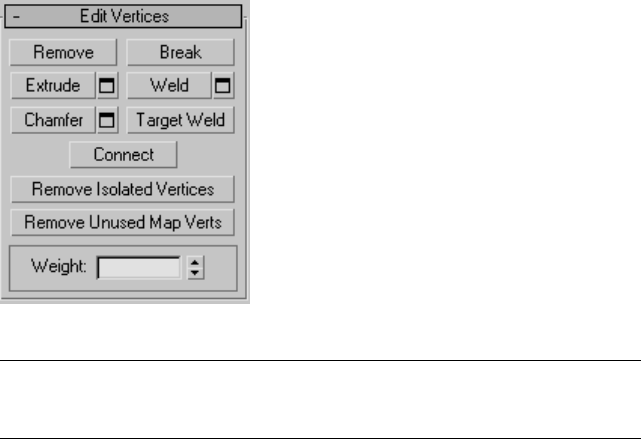
as Bend) applied to the object. This provides a magnet-like effect with a sphere
of influence around the selection.
For more information, see Soft Selection Rollout on page 1926 .
Edit Vertices rollout
This rollout includes commands specific to vertex editing.
NOTE To delete vertices, select them and press the Delete key. This can create
one or more holes in the mesh. To delete vertices without creating holes, use
Remove (see below).
Remove Deletes selected vertices and combines the polygons that use them.
The keyboard shortcut is Backspace.
2058 | Chapter 10 Surface Modeling
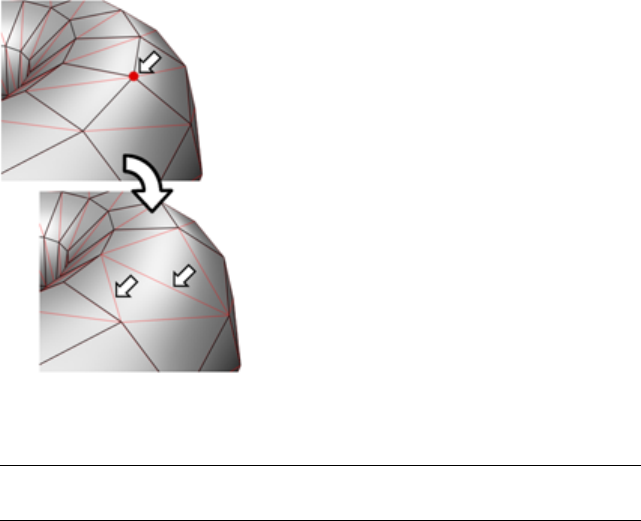
Removing one or more vertices deletes them and retriangulates the mesh to keep the
surface intact. If you use Delete instead, the polygons depending on those vertices are
deleted as well, creating a hole in the mesh.
WARNING Use of Remove can result in mesh shape changes and non-planar
polygons.
Break Creates a new vertex for each polygon attached to selected vertices,
allowing the polygon corners to be moved away from each other where they
were once joined at each original vertex. If a vertex is isolated or used by only
one polygon, it is unaffected.
Extrude Lets you extrude vertices manually via direct manipulation in the
viewport. Click this button, and then drag vertically on any vertex to extrude
it.
Extruding a vertex moves it along a normal and creates new polygons that
form the sides of the extrusion, connecting the vertex to the object. The
extrusion has the same number of sides as the number of polygons that
originally used the extruded vertex.
Following are important aspects of vertex extrusion:
■When over a selected vertex, the mouse cursor changes to an Extrude
cursor.
■Drag vertically to specify the extent of the extrusion, and horizontally to
set the size of the base.
Editable Poly (Vertex) | 2059
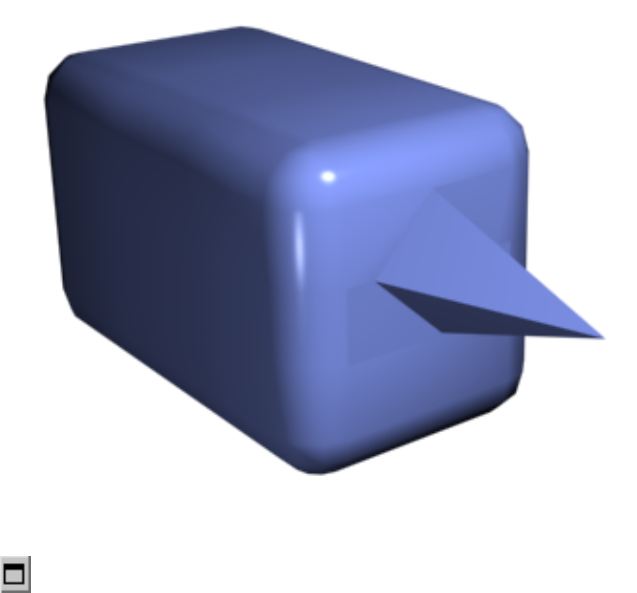
■With multiple vertices selected, dragging on any one extrudes all selected
vertices equally.
■You can drag other vertices in turn to extrude them while the Extrude
button is active. Click Extrude again or right-click in the active viewport
to end the operation.
Chamfer box showing extruded vertex
Extrude Settings Opens the Extrude Vertices dialog on page 2142 , which
lets you perform extrusion via interactive manipulation.
If you click this button after performing a manual extrusion, the same extrusion
is performed on the current selection as a preview and the dialog opens with
Extrusion Height set to the amount of the last manual extrusion.
Weld Combines contiguous, selected vertices that fall within the tolerance
specified in Weld dialog on page 2150 . All edges become connected to the
resulting single vertex.
Weld is best suited to automatically simplifying geometry that has areas with
a number of vertices that are very close together. Before using Weld, set the
2060 | Chapter 10 Surface Modeling

Weld Threshold via the Weld dialog on page 2150 . To weld vertices that are
relatively far apart, use Target Weld on page 2062 instead.
Weld Settings Opens the Weld dialog on page 2150 , which lets you
specify the weld threshold.
Chamfer Click this button and then drag vertices in the active object. To
chamfer vertices numerically, click the Chamfer Settings button and use the
Chamfer Amount value.
If you chamfer multiple selected vertices, all of them are chamfered identically.
If you drag an unselected vertex, any selected vertices are first deselected.
Each chamfered vertex is effectively replaced by a new face that connects new
points on all edges leading to the original vertex. These new points are exactly
<chamfer amount> distance from the original vertex along each of these edges.
New chamfer faces are created with the material ID of one of the neighboring
faces (picked at random) and a smoothing group which is an intersection of
all neighboring smoothing groups.
For example, if you chamfer one corner of a box, the single corner vertex is
replaced by a triangular face whose vertices move along the three edges that
led to the corner. Outside faces are rearranged and split to use these three new
vertices, and a new triangle is created at the corner.
Alternatively, you can create open space around the chamfered vertices; for
details, see Chamfer Vertices dialog on page 2136 .
Editable Poly (Vertex) | 2061
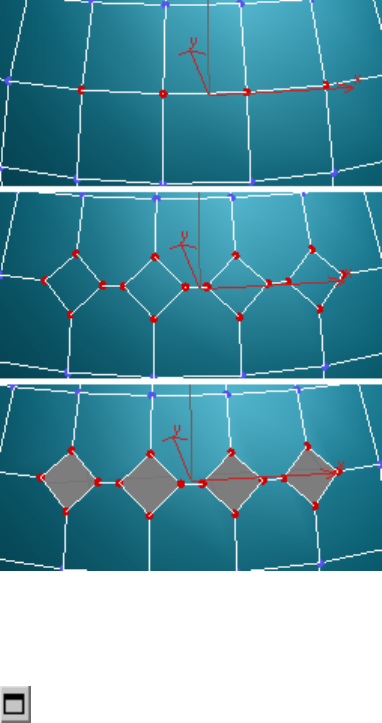
Top: The original vertex selection
Center: Vertices chamfered
Bottom: Vertices chamfered with Open on
Chamfer Settings Opens the Chamfer Vertices dialog on page 2136 , which
lets you chamfer vertices via interactive manipulation and toggle the Open
option.
If you click this button after performing a manual chamfer, the same chamfer
is performed on the current selection as a preview and the dialog opens with
Chamfer Amount set to the amount of the last manual extrusion.
Target Weld Allows you to select a vertex and weld it to a neighboring target
vertex. Target Weld works only with pairs of contiguous vertices; that is,
vertices connected by a single edge.
In Target Weld mode, the mouse cursor, when positioned over a vertex,
changes to a + cursor. Click and then move the mouse; a dashed, rubber-band
2062 | Chapter 10 Surface Modeling
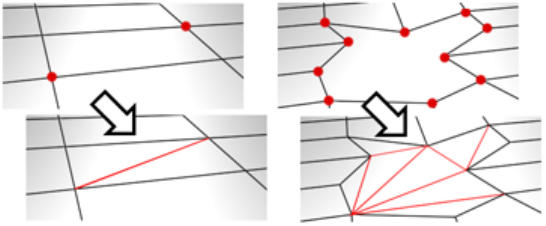
line connects the vertex to the mouse cursor. Position the cursor over another,
neighboring vertex and when the + cursor appears again, click the mouse. The
first vertex is moved to the position of the second, the two are welded, and
Target Weld mode is automatically exited.
Connect Creates new edges between pairs of selected vertices.
Connect will not let the new edges cross. Thus, for example, if you select all
four vertices of a four-sided polygon and then click Connect, only two of the
vertices will be connected. In this case, to connect all four vertices with new
edges, use Cut on page 2113 .
Remove Isolated Vertices Deletes all vertices that don't belong to any
polygons.
Remove Unused Map Verts Certain modeling operations can leave unused
(isolated) map vertices that show up in the Unwrap UVW editor on page 1788
, but cannot be used for mapping. You can use this button to automatically
delete these map vertices.
Weight Sets the weight of selected vertices. Used by the NURMS subdivision
option on page 2119 and by the MeshSmooth modifier on page 1460 . Increasing
a vertex weight tends to pull the smoothed result toward the vertex.
Editable Poly (Vertex) | 2063
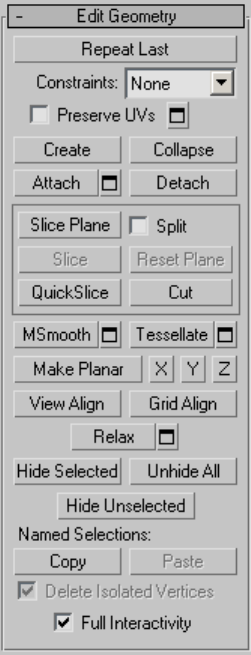
Edit Geometry rollout
See Edit Geometry Rollout (Polymesh) on page 2105 for detailed descriptions
of these controls.
2064 | Chapter 10 Surface Modeling
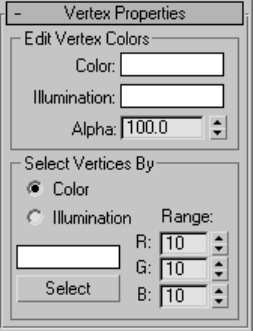
Vertex Properties rollout
Edit Vertex Colors group
Use these controls to assign the color, and illumination color (shading) of
selected vertices.
Color Click the color swatch to change the color of selected vertices.
Illumination Click the color swatch to change the illumination color of
selected vertices. This lets you change the illumination without changing the
vertex's color.
Alpha Lets you set specific alpha values of selected vertices. These alpha
values are maintained by the pipeline and can be used in conjunction with
vertex color to provide full RGBA data for export.
Select Vertices By group
Color/Illumination Determines whether to select vertices by vertex color
values or vertex illumination values.
Color Swatch Displays the Color Selector on page 331 , where you can specify
a color to match.
Select Depending on which radio button is chosen, selects all vertices whose
vertex color or illumination values either match the color swatch, or are within
the range specified by the RGB spinners.
Range Specifies a range for the color match. All three RGB values in the
vertex color or illumination must either match the color specified by the color
Editable Poly (Vertex) | 2065
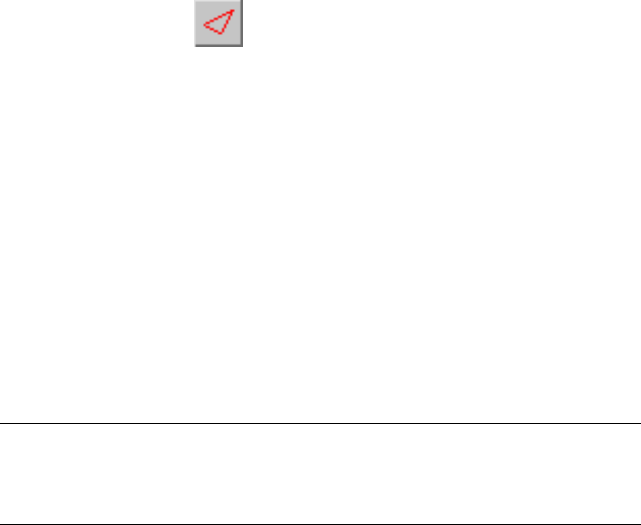
swatch in Select By Vertex Color, or be within plus or minus the values in the
Range spinners. Default=10.
Subdivision Surface rollout
See Interface on page 2119 for information on the Subdivision Surface rollout
settings.
Subdivision Displacement rollout
See Interface on page 2124 for information on the Subdivision Displacement
rollout settings.
Paint Deformation rollout
Paint Deformation lets you stroke elevated and indented areas directly onto
object surfaces. For more information, see Paint Deformation Rollout on page
2125 .
Editable Poly (Edge)
Select an editable poly object. > Modify panel > Selection rollout > Edge
Select an editable poly object. > Modify panel > Modifier Stack display > Expand
Editable Poly. > Edge
Select an editable poly object. > Quad menu > Tools 1 quadrant > Edge
An edge is a line connecting two vertices that forms the side of a polygon. An
edge can't be shared by more than two polygons. Also, the normals of the two
polygons should be adjacent. If they aren't, you wind up with two edges that
share vertices.
At the editable poly Edge sub-object level, you can select single and multiple
edges and transform them using standard methods. This topic covers the Edit
Geometry and Edit Edges rollouts; for other controls, see Editable Poly on
page 2038 .
NOTE Besides edges, each polygon has one or more internal diagonals on page
7757 that determine how the polygon is triangulated by the software. Diagonals
can't be manipulated directly, but you can use the Turn on page 2083 and Edit
Triangulation on page 2083 functions to change their positions.
2066 | Chapter 10 Surface Modeling
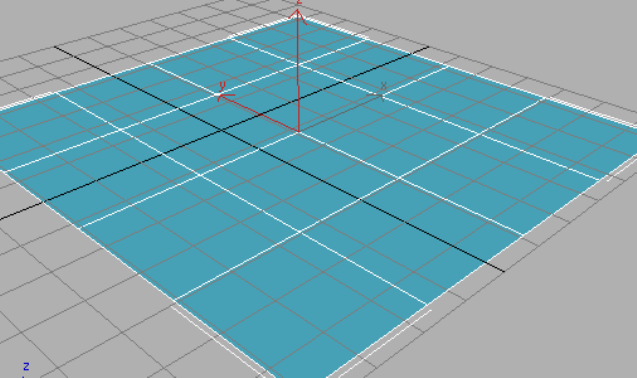
Procedures
Example: To use the Cut and Turn features:
3ds Max provides a convenient function for turning edges, which, along with
the Cut feature, streamlines the custom modeling process considerably.
Specifically, cutting a new polygon into existing geometry minimizes the
number of extra visible edges, typically adding none or one. And after using
cut, the Turn function lets you adjust any diagonal with a single click.
1In the Perspective viewport, add a Plane object. This object is available
from the Create panel > Standard Primitives > Object Type rollout.
By default, the Plane object is divided into 4 x 4 polygons. If you don't
see the polygons in the Perspective viewport, press F4 to activate Edged
Faces view mode.
2Convert the Plane object to Editable Poly format. If you're not sure how,
continue in this step; otherwise, skip to the next step after converting.
To convert the object, right-click once in the Perspective viewport to exit
create mode. This leaves the object selected. Right-click again in the
Perspective viewport, and then at the bottom of the Transform quadrant,
choose Convert To > Convert To Editable Poly. Alternatively, apply the
Edit Poly modifier.
Editable Poly (Edge) | 2067
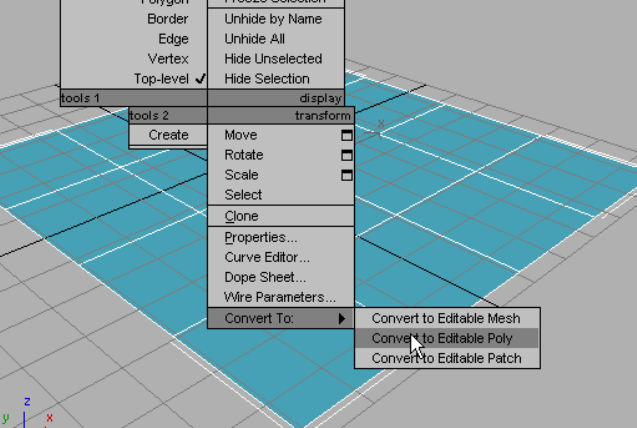
The object is now an editable poly and the command panel switches to
the Modify panel.
3Cut is available at the object level as well as at every sub-object level. On
the Edit Geometry rollout, find the Cut button, and then click it.
4In the Perspective viewport, position the mouse cursor in the center of
a corner polygon, such as the one closest to you, click once, and then
move the mouse around the viewport.
2068 | Chapter 10 Surface Modeling
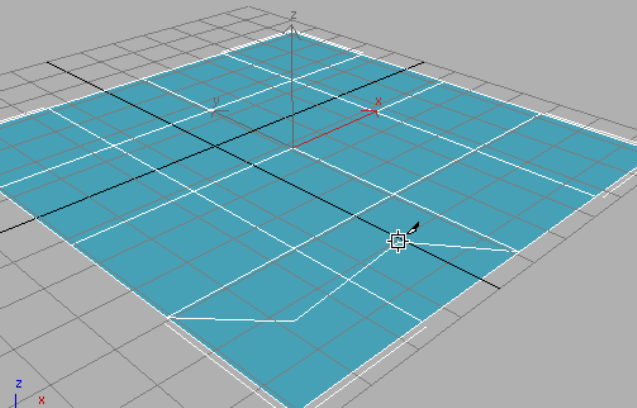
Two or three lines appear and move as you move the mouse. One line
connects the mouse cursor to the original click location, and indicates
where the next cut will appear when you click the mouse button. Another
connects to a corner of the polygon; this connection changes depending
on the mouse position. And, if the cursor isn't over an edge or a vertex
(it changes appearance if it is, depending on which), a third line connects
the mouse cursor to another vertex.
This demonstrates one aspect of the new Cut functionality; in previous
versions, the first click in a Cut operation connected to two corners of
the polygon.
5Continue cutting in a rectangular pattern, clicking once at the center of
a different polygon, finish by clicking once more at the starting point,
and then right-click to exit Cut mode.
Editable Poly (Edge) | 2069
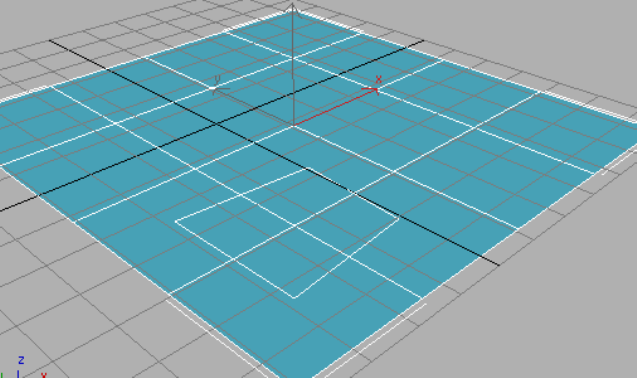
The result is a rectangle across four polygons, without any connecting
visible edges. In previous versions, you would have had eight connecting
visible edges: two in each of the original polygons. Note that all the edges
you created are selected, and ready for further transformation or editing.
6Cut a rectangle into the center of a single polygon.
In this case you end up with a single, additional visible edge instead of
seven, as in previous versions. The edge connects corner of the new
polygon with a corner of the original one. This new edge is not selected,
but the ones you created explicitly are.
2070 | Chapter 10 Surface Modeling
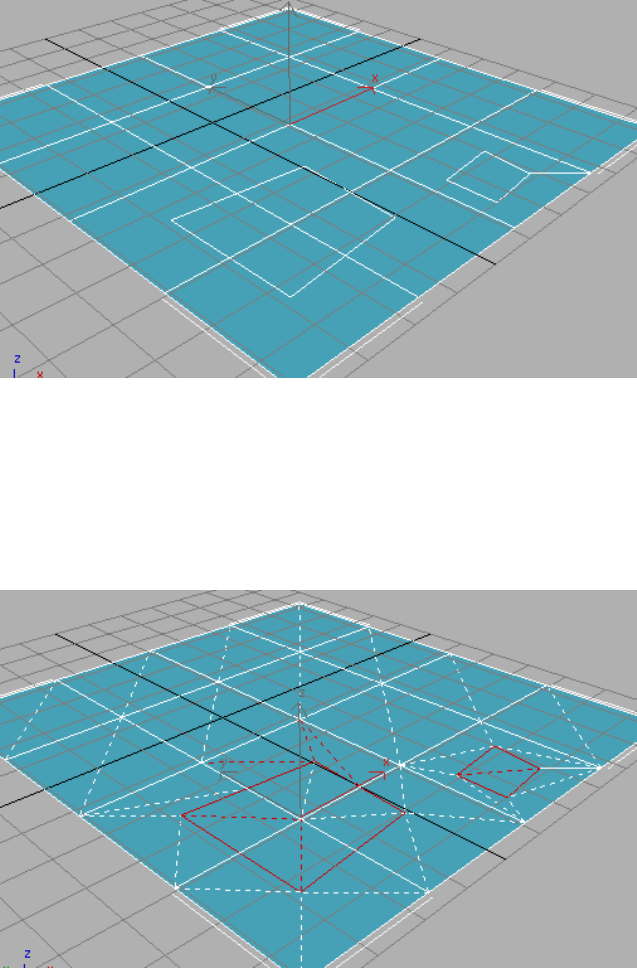
Connecting the remaining corners are a number of diagonals on page
7757 , which serve to fully triangulate the polygons. The new Turn function
lets you manipulate each of these with a single click.
7Go to the Edge sub-object level, and then, on the Edit Edges rollout, click
Turn.
All diagonals, including those created from the Cut operations, appear
as dashed lines.
Editable Poly (Edge) | 2071
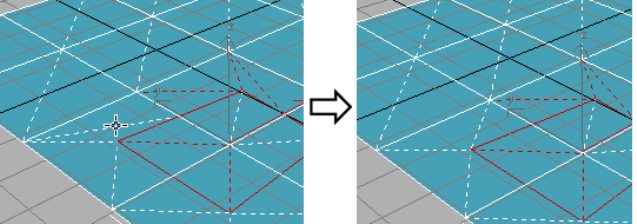
8Click a diagonal to turn it, and then click it again to return it to its original
status.
In Turn mode, click a diagonal (dashed line) once to turn it.
Each diagonal has only two different available positions, given no changes
in any other diagonals' or edges' positions.
Compare this with the Edit Triangulation tool, with which you must
click two vertices to change a diagonal's position.
This simple demonstration shows how, when manually subdividing a
polygon mesh for modeling and animation purposes, you can save a good
deal of time by using the Cut and Turn tools in 3ds Max.
To create a shape from one or more edges:
1Select the edges you want to make into shapes.
2On the Edit Edges rollout, click Create Shape From Selection.
3Make changes, as needed, on the Create Shape dialog that appears.
■Enter a curve name or keep the default.
■Choose Smooth or Linear as the shape type.
4Click OK.
The resulting shape consists of one or more splines whose vertices are
coincident with the vertices in the selected edges. The Smooth option
results in vertices using smooth values, while the Linear option results
in linear splines with corner vertices.
If the selected edges are not continuous, or if they branch, the resulting
shape will consist of more than one spline. When the Create Shape
function runs into a branching 'Y' in the edges, it makes an arbitrary
decision as to which edge produces which spline. If you need to control
2072 | Chapter 10 Surface Modeling
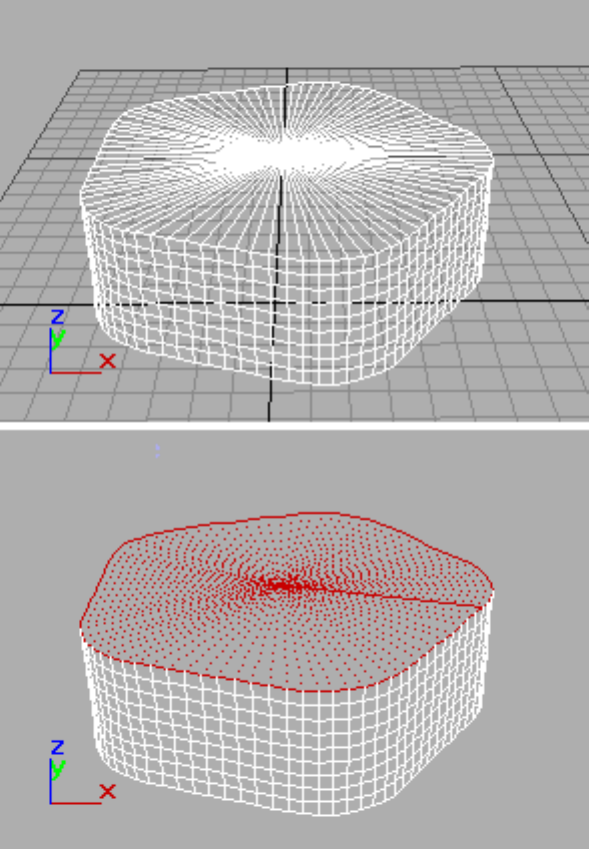
this, select only those edges that will result in a single spline, and perform
a Create Shape operation repeatedly to make the correct number of shapes.
Finally, use Attach on page 627 in the Editable Spline to combine the
shapes into one.
Above: Original object
Editable Poly (Edge) | 2073
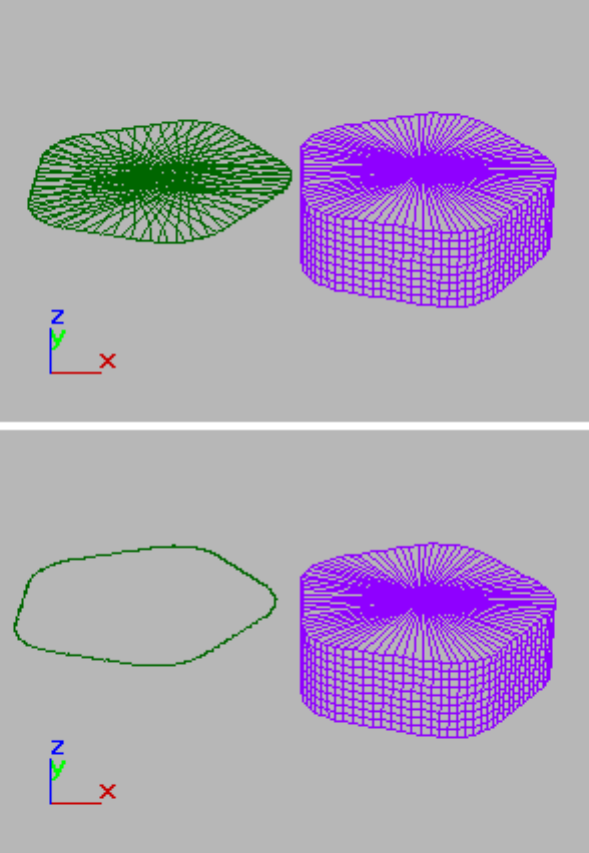
Below: Object with edges selected
Above: Selected edges removed from original object
Below: Unwanted edges removed
2074 | Chapter 10 Surface Modeling
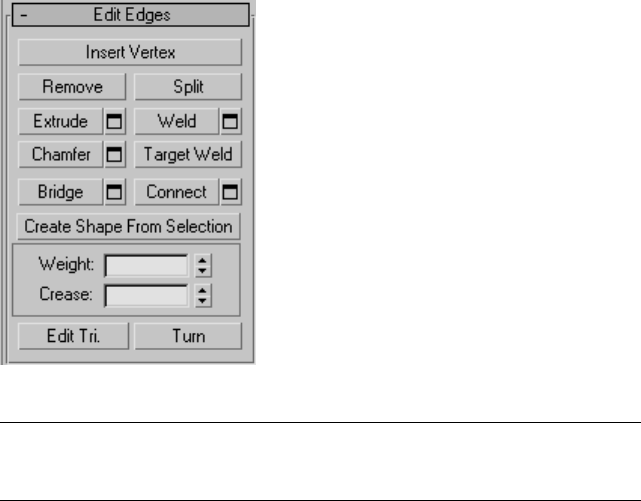
Interface
Selection rollout
See Editable Poly on page 2046 for information on the Select rollout settings.
Soft Selection rollout
Soft Selection controls apply a smooth falloff between selected sub-objects
and unselected ones. When Use Soft Selection is on, unselected sub-objects
near your selection are given partial selection values. These values are shown
in the viewports by means of a color gradient on the vertices, and optionally
on the faces. They affect most types of sub-object deformations, such as the
Move, Rotate, and Scale functions, as well as any deformation modifiers (such
as Bend) applied to the object. This provides a magnet-like effect with a sphere
of influence around the selection.
For more information, see Soft Selection Rollout on page 1926 .
Edit Edges rollout
This rollout includes commands specific to edge editing.
NOTE To delete edges, select them and press the Delete key. This deletes all
selected edges and attached polygons, which can create one or more holes in the
mesh. To delete edges without creating holes, use Remove on page 2076 .
Editable Poly (Edge) | 2075
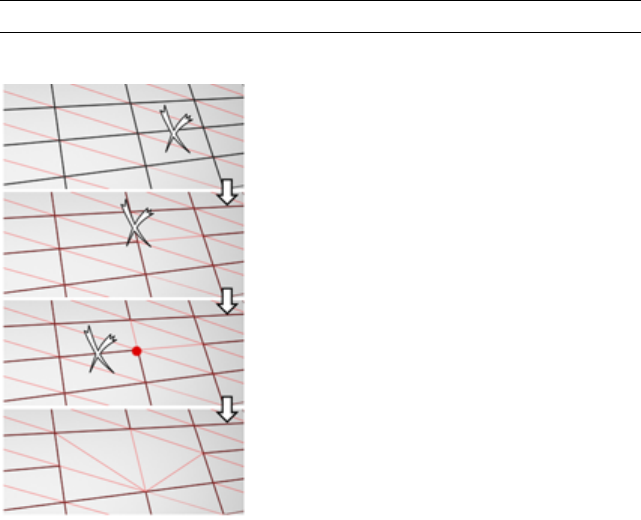
Insert Vertex Lets you subdivide visible edges manually.
After turning on Insert Vertex, click an edge to add a vertex at that location.
You can continue subdividing polygons as long as the command is active.
To stop inserting edges, right-click in the viewport, or click Insert Vertex again
to turn it off.
NOTE In previous versions of the software, this command was called Divide.
Remove Deletes selected edges and combines the polygons that use them.
Removing one edge is like making it invisible. The mesh is affected only when all or all
but one of the edges depending on one vertex are removed. At that point, the vertex
itself is deleted and the surface is retriangulated.
To delete the associated vertices when you remove edges, press and hold Ctrl
while execut.ing a Remove operation, either by mouse or with the Backspace
key. This option, called Clean Remove, ensures that the remaining polygons
are planar.
2076 | Chapter 10 Surface Modeling
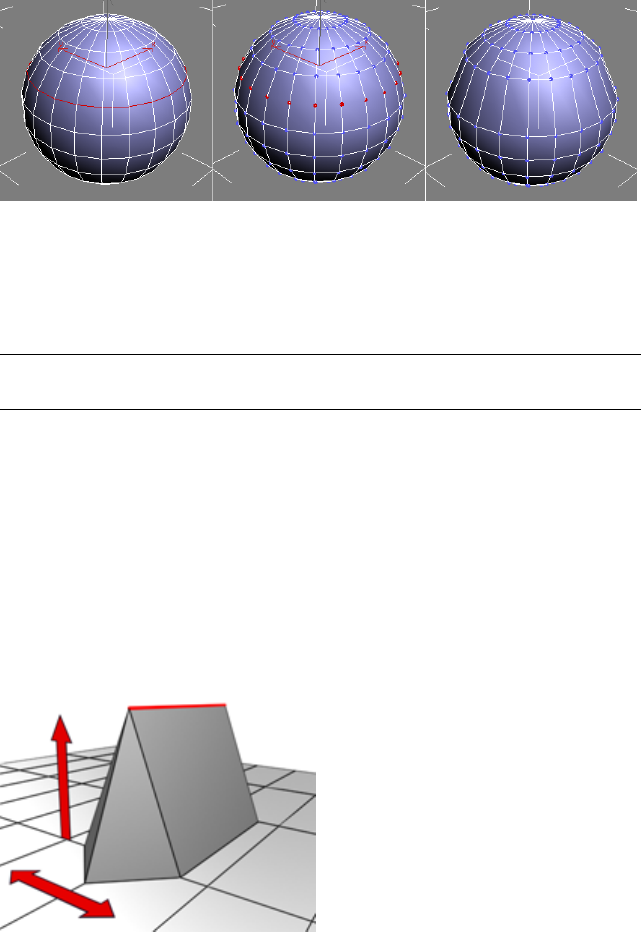
Left: The original edge selection
Center: Standard Remove operation leaves extra vertices.
Right: Clean Remove with Ctrl+Remove deletes the extra vertices.
Edges with the same polygon on both sides usually can't be removed.
WARNING Use of Remove can result in mesh shape changes and non-planar
polygons.
Split Divides the mesh along the selected edges.
This does nothing when applied to a single edge in the middle of a mesh. The
vertices at the end of affected edges must be separable in order for this option
to work. For example, it would work on a single edge that intersects an existing
border, since the border vertex can be split in two. Additionally, two adjacent
edges could be split in the middle of a grid or sphere, since the shared vertex
can be split.
Extrude Lets you extrude edges manually via direct manipulation in the
viewport. Click this button, and then drag vertically on any edge to extrude
it.
When extruding a vertex or edge interactively in the viewport, you set the extrusion
height by moving the mouse vertically and the base width by moving the mouse
horizontally.
Editable Poly (Edge) | 2077
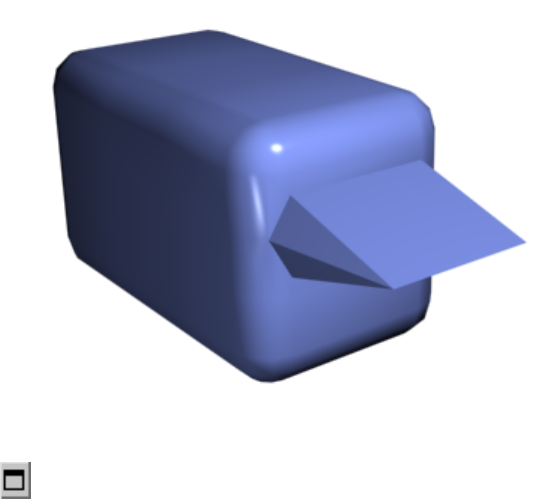
Extruding an edge moves it along a normal and creates new polygons that
form the sides of the extrusion, connecting the edge to the object. The
extrusion has either three or four sides; three if the edge was on a border, or
four if it was shared by two polygons. As you increase the length of the
extrusion, the base increases in size, to the extent of the vertices adjacent to
the extruded edge's endpoints.
Following are important aspects of edge extrusion:
■When over a selected edge, the mouse cursor changes to an Extrude cursor.
■Drag vertically to specify the extent of the extrusion, and horizontally to
set the size of the base.
■With multiple edges selected, dragging on any one extrudes all selected
edges equally.
■You can drag other edges in turn to extrude them while the Extrude button
is active. Click Extrude again or right-click in the active viewport to end
the operation.
Chamfer box showing extruded edge
Extrude Settings Opens the Extrude Edges dialog on page 2142 , which
lets you perform extrusion via interactive manipulation.
2078 | Chapter 10 Surface Modeling

If you click this button after performing a manual extrusion, the same extrusion
is performed on the current selection as a preview and the dialog opens with
Extrusion Height set to the amount of the last manual extrusion.
Weld Combines selected edges that fall within the threshold specified in
Weld dialog on page 2150 .
You can weld only edges that have one polygon attached; that is, edges on a
border. Also, you cannot perform a weld operation that would result in illegal
geometry (e.g., an edge shared by more than two polygons). For example, you
cannot weld opposite edges on the border of a box that has a side removed.
Weld Settings Opens the Weld dialog on page 2150 , which lets you specify
the weld threshold.
Chamfer Click this button and then drag edges in the active object. To
chamfer vertices numerically, click the Chamfer Settings button and change
the Chamfer Amount value.
If you chamfer multiple selected edges, all of them are chamfered identically.
If you drag an unselected edge, any selected edges are first deselected.
An edge chamfer "chops off" the selected edges, creating a new polygon
connecting new points on all visible edges leading to the original vertex. The
new edges are exactly <chamfer amount> distance from the original edge
along each of these edges. New chamfer faces are created with the material
ID of one of the neighboring faces (picked at random) and a smoothing group
which is an intersection of all neighboring smoothing groups.
For example, if you chamfer one edge of a box, each corner vertex is replaced
by two vertices moving along the visible edges that lead to the corner. Outside
faces are rearranged and split to use these new vertices, and a new polygon is
created at the corner.
Alternatively, you can create open space around the chamfered edges; for
details, see Chamfer Edges dialog on page 2136 .
Chamfer Settings Opens the Chamfer Edges dialog on page 2136 , which
lets you chamfer edges via interactive manipulation and toggle the Open
option.
If you click this button after performing a manual chamfer, the same chamfer
is performed on the current selection as a preview and the dialog opens with
Chamfer Amount set to the amount of the last manual chamfer.
Target Weld Allows you to select an edge and weld it to a target edge. When
positioned over an edge, the cursor changes to a + cursor. Click and move the
mouse and a dashed line appears from the vertex with an arrow cursor at the
Editable Poly (Edge) | 2079

other end of the line. Position the cursor over another edge and when the +
cursor appears again, click the mouse. The first edge is moved to the position
of the second, and the two are welded.
You can weld only edges that have one polygon attached; that is, edges on a
border. Also, you cannot perform a weld operation that would result in illegal
geometry (e.g., an edge shared by more than two polygons). For example, you
cannot weld opposite edges on the border of a box that has a side removed.
Bridge Connects border edges on an object with a polygon “bridge.” Bridge
connects only border edges; that is, edges that have a polygon on only one
side. This tool is particularly useful when creating edge loops or profiles.
There are two ways to use Bridge in Direct Manipulation mode (that is, without
opening the Bridge Edges settings dialog):
■Select two or more border edges on the object, and then click Bridge. This
immediately creates the bridge between the pair of selected borders using
the current Bridge settings, and then deactivates the Bridge button.
■If no qualifying selection exists (that is, two or more selected border edges),
clicking Bridge activates the button and places you in Bridge mode. First
click a border edge and then move the mouse; a rubber-band line connects
the mouse cursor to the clicked edge. Click a second edge on a different
border to bridge the two. This creates the bridge immediately using the
current Bridge settings; the Bridge button remains active for connecting
more edges. To exit Bridge mode, right-click the active viewport or click
the Bridge button.
NOTE Bridge always creates a straight-line connection between edges. To make
the bridge connection follow a contour, apply modeling tools as appropriate after
creating the bridge. For example, bridge two edges, and then use Bend on page
1139 .
Bridge Settings Opens the Bridge Edges dialog on page 2133 , which lets
you add polygons between pairs of edges via interactive manipulation.
Connect Creates new edges between pairs of selected edges using the current
Connect Edges dialog settings. Connect is particularly useful for creating or
refining edge loops.
2080 | Chapter 10 Surface Modeling
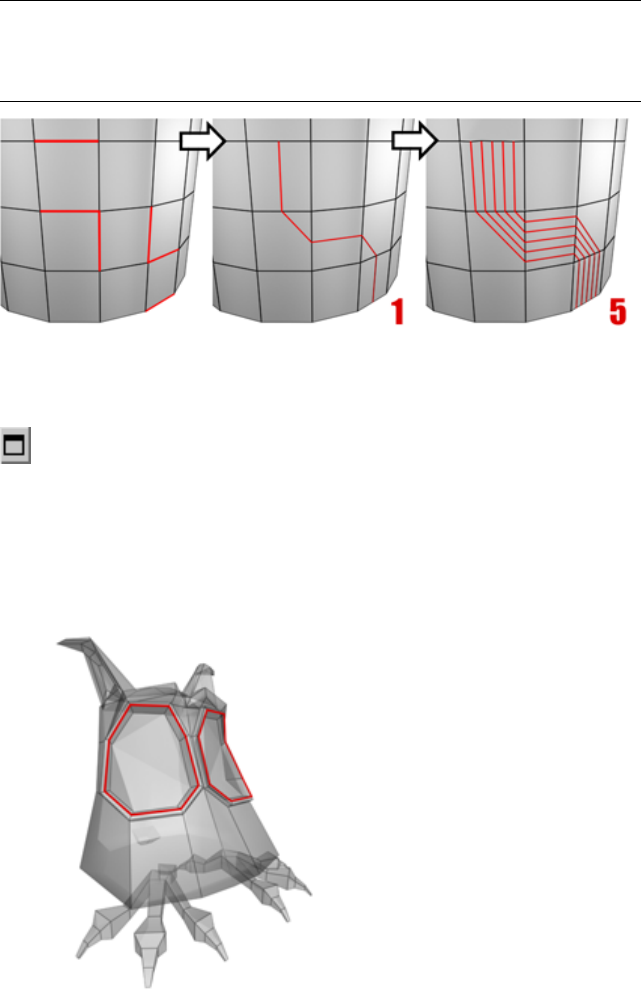
NOTE You can connect only edges on the same polygon. Also, Connect will not
let the new edges cross. For example, if you select all four edges of a four-sided
polygon and then click Connect, only neighboring edges are connected, resulting
in a diamond pattern.
Connecting two or more edges using the Settings dialog creates equally spaced edges.
The number of edges is set in the dialog. When you click the Connect button, the
current dialog settings are applied to the selection.
Connect Settings Opens the Connect Edges dialog on page 2137 , which
lets you preview the Connect results, specify the number of edge segments
created by the operation, and set spacing and placement for the new edges.
Create Shape From Selection After selecting one or more edges, click this
button to create a spline shape from the selected edges. A Create Shape dialog
appears, letting you name the shape and set it to Smooth or Linear. The new
shape's pivot is placed at the center of the poly object.
Editable Poly (Edge) | 2081
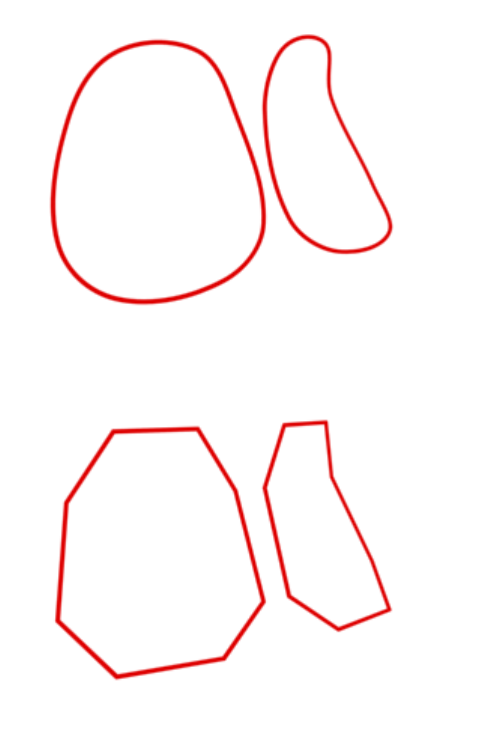
An edge selection (top); a smooth shape (center); a linear shape (bottom)
Weight Sets the weight of selected edges. Used by the NURMS subdivision
option on page 2119 and by the MeshSmooth modifier on page 1460 .
Increasing an edge weight tends to push the smoothed result away.
Crease Specifies how much creasing is performed on the selected edge or
edges. Used by the NURMS subdivision option on page 2119 and by the
MeshSmooth modifier on page 1460 .
2082 | Chapter 10 Surface Modeling
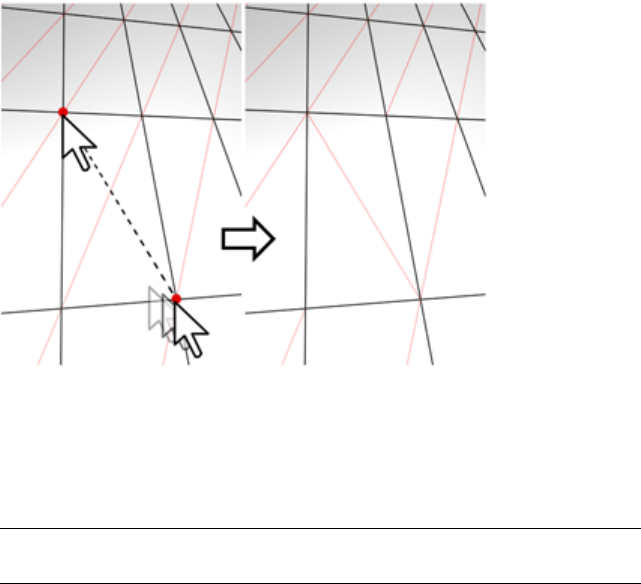
At low settings, the edge is relatively smooth. At higher settings, the crease
becomes increasingly visible. At 1.0, the highest setting, the edge becomes a
hard crease.
Edit Tri[angulation] Lets you modify how polygons are subdivided into
triangles by drawing internal edges, or diagonals on page 7757 .
In Edit Triangulation mode, you can see the current triangulation in the viewport, and
change it by clicking two vertices on the same polygon.
To edit triangulation manually, turn on this button. The hidden edges appear.
Click a polygon vertex. A rubber-band line appears, attached to the cursor.
Click a non-adjacent vertex to create a new triangulation for the polygon.
TIP For easier editing of triangulation, use the Turn command instead (see
following).
Turn Lets you modify how polygons are subdivided into triangles by clicking
diagonals. When you activate Turn, the diagonals on page 7757 become visible
as dashed lines in wireframe and edged-faces views. In Turn mode, click a
diagonal to change its position. To exit Turn mode, right-click in the viewport
or click the Turn button again.
Each diagonal has only two available positions at any given time, so clicking
a diagonal twice in succession simply returns it to its original position. But
changing the position of a nearby diagonal can make a different alternate
position available to a diagonal.
Editable Poly (Edge) | 2083
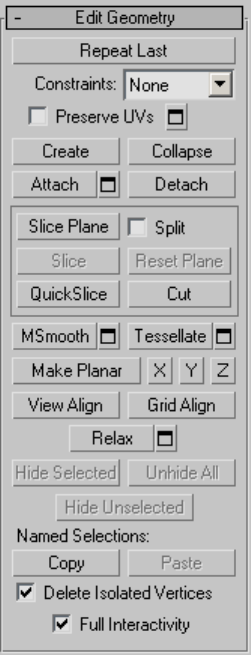
For more information on how to use Turn with the enhanced Cut tool, see
this procedure on page ? .
Edit Geometry rollout
See Edit Geometry Rollout (Polymesh) on page 2105 for detailed descriptions
of these controls.
Subdivision Surface rollout
See Interface on page 2119 for information on the Subdivision Surface rollout
settings.
2084 | Chapter 10 Surface Modeling

Subdivision Displacement rollout
See Interface on page 2124 for information on the Subdivision Displacement
rollout settings.
Paint Deformation rollout
Paint Deformation lets you stroke elevated and indented areas directly onto
object surfaces. For more information, see Paint Deformation Rollout on page
2125 .
Editable Poly (Border)
Select an editable poly object. > Modify panel > Selection rollout > Border
Select an editable poly object. > Modify panel > Modifier Stack display > Expand
Editable Poly. > Border
Select an editable poly object. > Quad menu > Tools 1 quadrant > Border
A border is a linear section of a mesh that can generally be described as the
edge of a hole. This is usually a sequence of edges with polygons on only one
side. For example, a box doesn't have a border, but the teapot object has
several: on the lid, on the body, on the spout, and two on the handle. If you
create a cylinder, and then delete an end polygon, the adjacent row of edges
forms a border.
At the editable poly Border sub-object level, you can select single and multiple
borders and transform them using standard methods. This topic covers the
Edit Geometry and Edit Borders rollouts; for other controls, see Editable Poly
on page 2038 .
Procedures
To create a polygon that closes the surface at the selected border:
1At the Border sub-object level, select any open edge.
This selects the entire closed loop of continuous open edges that make
up the border selection.
2Click Cap.
Editable Poly (Border) | 2085
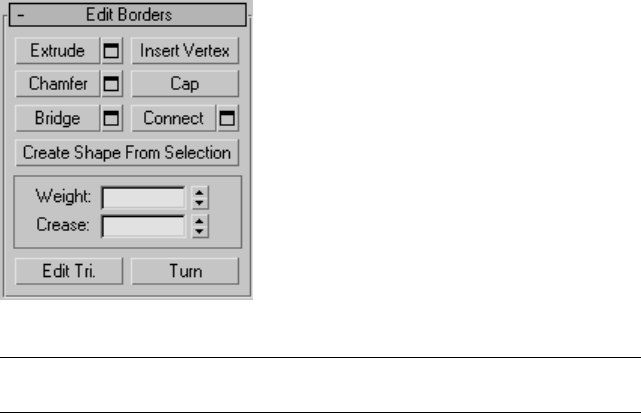
Interface
Selection rollout
See Editable Poly on page 2046 for information on the Selection rollout settings.
Soft Selection rollout
Soft Selection controls apply a smooth falloff between selected sub-objects
and unselected ones. When Use Soft Selection is on, unselected sub-objects
near your selection are given partial selection values. These values are shown
in the viewports by means of a color gradient on the vertices, and optionally
on the faces. They affect most types of sub-object deformations, such as the
Move, Rotate, and Scale functions, as well as any deformation modifiers (such
as Bend) applied to the object. This provides a magnet-like effect with a sphere
of influence around the selection.
For more information, see Soft Selection Rollout on page 1926 .
Edit Borders rollout
This rollout includes commands specific to editing borders.
NOTE To delete a border, select it and press the Delete key. This deletes the border
and all attached polygons.
Extrude Lets you extrude a border manually via direct manipulation in the
viewport. Click this button, and then drag vertically on any border to extrude
it.
2086 | Chapter 10 Surface Modeling
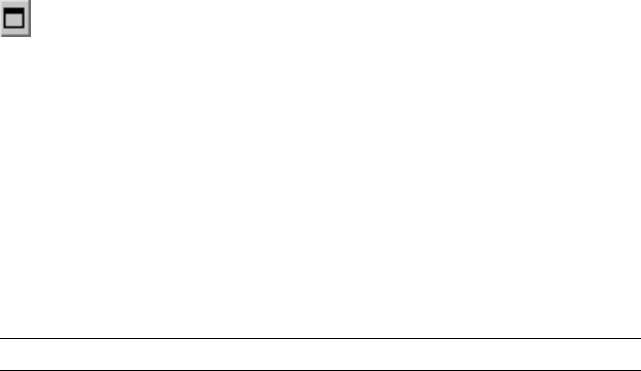
Extruding a border moves it along a normal and creates new polygons that
form the sides of the extrusion, connecting the border to the object. The
extrusion can form a varying number of additional sides, depending on the
geometry near the border. As you increase the length of the extrusion, the
base increases in size, to the extent of the vertices adjacent to the extruded
border's endpoints.
Following are important aspects of border extrusion:
■When over a selected border, the mouse cursor changes to an Extrude
cursor.
■Drag vertically to specify the extent of the extrusion, and horizontally to
set the size of the base.
■With multiple borders selected, dragging on any one extrudes all selected
borders equally.
■You can drag other borders in turn to extrude them while the Extrude
button is active. Click Extrude again or right-click in the active viewport
to end the operation.
Extrude Settings Opens the Extrude Edges dialog on page 2142 , which
lets you perform extrusion via interactive manipulation.
If you click this button after performing a manual extrusion, the same extrusion
is performed on the current selection as a preview and the dialog opens with
Extrusion Height set to the amount of the last manual extrusion.
Insert Vertex Lets you subdivide border edges manually.
After turning on Insert Vertex, click a border edge to add a vertex at that
location. You can continue subdividing border edges as long as the command
is active.
To stop inserting vertices, right-click in the viewport, or click Insert Vertex
again to turn it off.
NOTE In previous versions of the software, this command was called Divide.
Chamfer Click this button and then drag a border in the active object. The
border need not be selected first.
If you chamfer multiple selected borders, all of them are chamfered identically.
If you drag an unselected border, any selected borders are first deselected.
Editable Poly (Border) | 2087
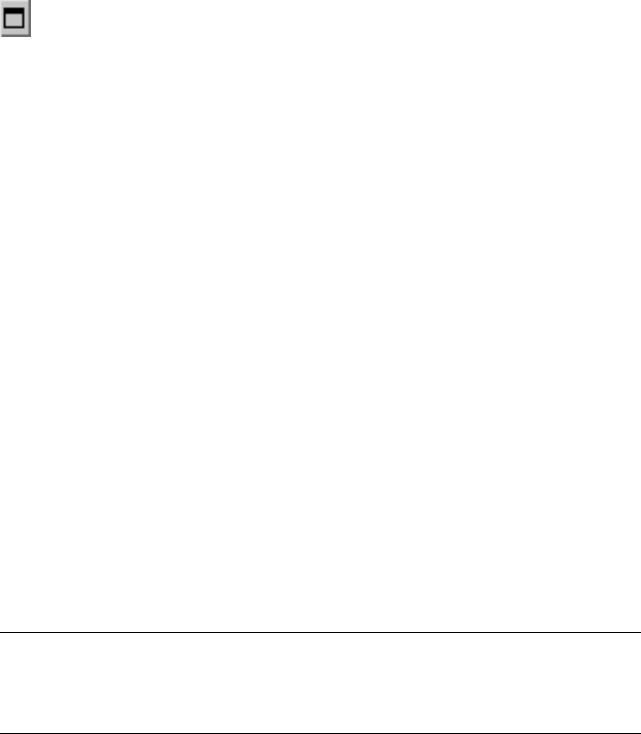
A border chamfer essentially “frames” the border edges, creating a new set of
edges paralleling the border edges, plus new diagonal edges at any corners.
These new edges are exactly <chamfer amount> distance from the original
edges. New chamfer faces are created with the material ID of one of the
neighboring faces (picked at random) and a smoothing group which is an
intersection of all neighboring smoothing groups.
Alternatively, you can create open space around the chamfered borders,
essentially cutting away at the open edges; for details, see Chamfer Edges
dialog on page 2136 .
Chamfer Settings Opens the Chamfer Edges dialog on page 2136 , which
lets you chamfer borders via interactive manipulation and toggle the Open
option.
If you click this button after performing a manual chamfer, the same chamfer
is performed on the current selection as a preview and the dialog opens with
Chamfer Amount set to the amount of the last manual chamfer.
Cap Caps an entire border loop with a single polygon.
Select the border, and then click Cap.
Bridge Connects two borders on an object with a polygon “bridge.” There
are two ways to use Bridge in Direct Manipulation mode (that is, without
opening the Bridge Settings dialog):
■Select an even number of borders on the object, and then click Bridge.
This immediately creates the bridge between each pair of selected borders
using the current Bridge settings, and then deactivates the Bridge button.
■If no qualifying selection exists (that is, two or more selected borders),
clicking Bridge activates the button and places you in Bridge mode. First
click a border edge and then move the mouse; a rubber-band line connects
the mouse cursor to the clicked edge. Click a second edge on a different
border to bridge the two. This creates the bridge immediately using the
current Bridge settings; the Bridge button remains active for connecting
more pairs of borders. To exit Bridge mode, right-click the active viewport
or click the Bridge button.
NOTE Bridge always creates a straight-line connection between border pairs. To
make the bridge connection follow a contour, apply modeling tools as appropriate
after creating the bridge. For example, bridge two borders, and then use Bend
on page 1139 .
2088 | Chapter 10 Surface Modeling
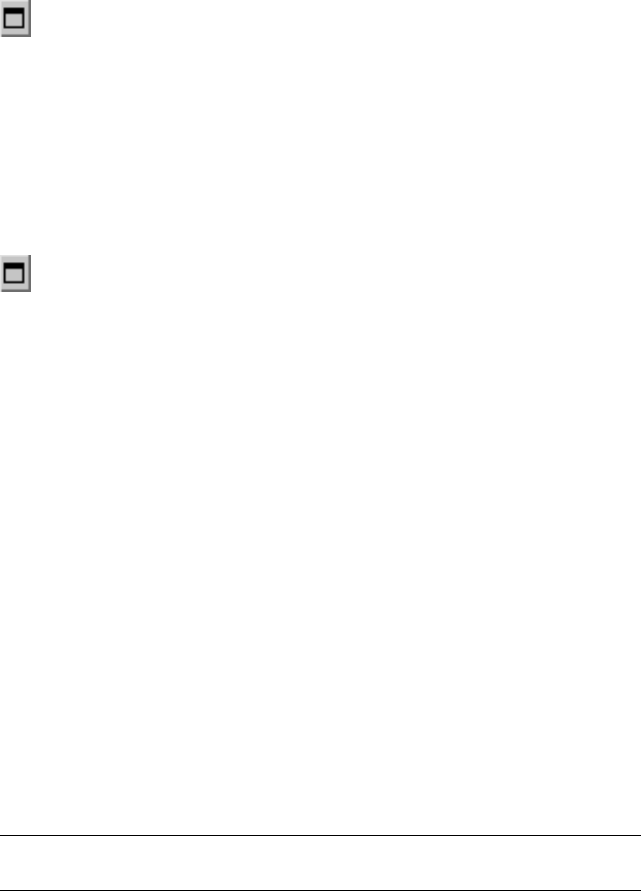
Bridge Settings Opens the Bridge dialog on page 2131 , which lets you
connect pairs of borders via interactive manipulation.
Connect Creates new edges between pairs of selected border edges. The edges
are connected from their midpoints.
You can connect only edges on the same polygon.
Connect will not let the new edges cross. Thus, for example, if you select all
four edges of a four-sided polygon and then click Connect, only neighboring
edges are connected, resulting in a diamond pattern.
Connect Settings Lets you preview the Connect and specify the number
of edge segments created by the operation. To increase the mesh resolution
around the new edge, increase the Connect Edge Segments setting.
Create Shape From Selection After selecting one or more borders, click this
button to create a spline shape from the selected edges. A Create Shape dialog
appears, letting you name the shape and set it to Smooth or Linear. The new
shape's pivot is placed at the center of the poly object.
Weight Sets the weight of selected borders. Used by the NURMS subdivision
option on page 2119 .
Increasing an edge weight tends to push the smoothed result away.
Crease Specifies how much creasing is performed on the selected border or
borders. Used by the NURMS subdivision option on page 2119 .
At low settings, the border is relatively smooth. At higher settings, the crease
becomes increasingly visible. At 1.0, the highest setting, the border is not
smoothed at all.
Edit Tri[angulation] Lets you modify how polygons are subdivided into
triangles by drawing internal edges, or diagonals on page 7757 .
To edit triangulation manually, turn on this button. The hidden edges appear.
Click a polygon vertex. A rubber-band line appears, attached to the cursor.
Click a non-adjacent vertex to create a new triangulation for the polygon.
TIP For easier editing of triangulation, use the Turn command instead (see
following).
Turn Lets you modify how polygons are subdivided into triangles by clicking
diagonals. When you activate Turn, the diagonals on page 7757 become visible
as dashed lines in wireframe and edged-faces views. In Turn mode, click a
Editable Poly (Border) | 2089
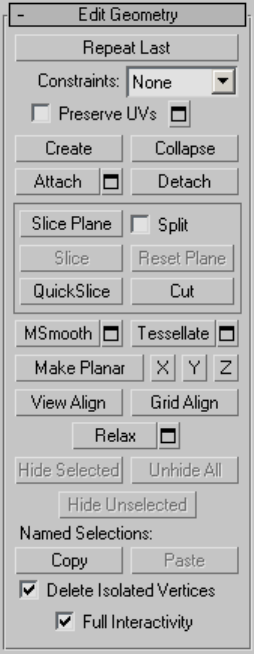
diagonal to change its position. To exit Turn mode, right-click in the viewport
or click the Turn button again.
Each diagonal has only two available positions at any given time, so clicking
a diagonal twice in succession simply returns it to its original position. But
changing the position of a nearby diagonal can make a different alternate
position available to a diagonal.
For more information on how to use Turn with the enhanced Cut tool, see
this procedure on page ? .
Edit Geometry rollout
See Edit Geometry Rollout (Polymesh) on page 2105 for detailed descriptions
of these controls.
2090 | Chapter 10 Surface Modeling
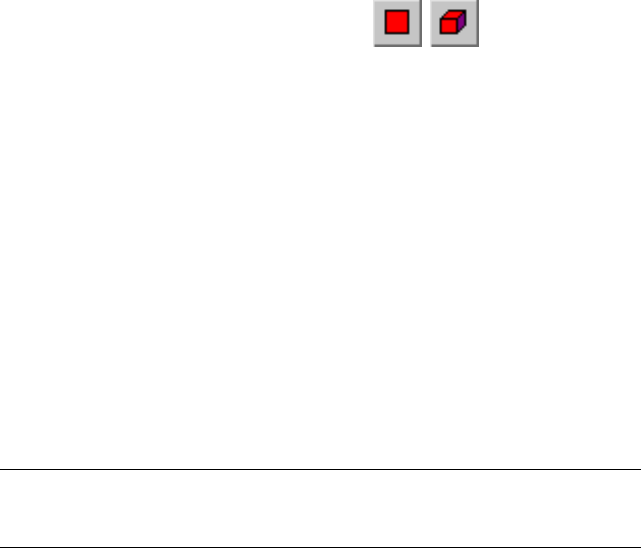
Subdivision Surface rollout
See Interface on page 2119 for information on the Subdivision Surface rollout
settings.
Subdivision Displacement rollout
See Interface on page 2124 for information on the Subdivision Displacement
rollout settings.
Paint Deformation rollout
Paint Deformation lets you stroke elevated and indented areas directly onto
object surfaces. For more information, see Paint Deformation Rollout on page
2125 .
Editable Poly (Polygon/Element)
Select an editable poly object. > Modify panel > Selection rollout > Polygon
or Element
Select an editable poly object. > Modify panel > Modifier Stack display > Expand
Editable Poly. > Polygon/Element
Select an editable poly object. > Quad menu > Tools 1 quadrant > Polygon or
Element
A polygon is a closed sequence of three or more edges connected by a surface.
Polygons provide the renderable surface of editable poly objects.
At the Editable Poly (Polygon) sub-object level, you can select single and
multiple polygons and transform them using standard methods. This is also
true for the Element sub-object level; for the distinctions between polygon
and element, see Editable Poly > Selection rollout on page 2046 . This topic
covers the Edit Polygons/Elements rollout and Edit Geometry rollout functions
for these sub-object types; for other controls, see Editable Poly on page 2038 .
NOTE Workflow enhancements in the Editable Poly user interface give you a
choice of editing methods. See Editable Poly Workflow on page 2039 for more
information.
Editable Poly (Polygon/Element) | 2091
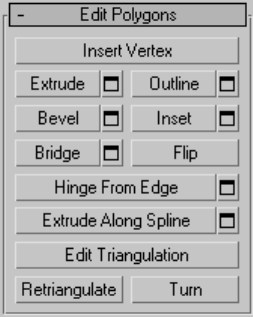
Interface
Selection rollout
See Editable Poly > Selection rollout on page 2046 for information on the
Selection rollout settings.
Soft Selection rollout
Soft Selection controls apply a smooth falloff between selected sub-objects
and unselected ones. When Use Soft Selection is on, unselected sub-objects
near your selection are given partial selection values. These values are shown
in the viewports by means of a color gradient on the vertices, and optionally
on the faces. They affect most types of sub-object deformations, such as the
Move, Rotate, and Scale functions, as well as any deformation modifiers (such
as Bend) applied to the object. This provides a magnet-like effect with a sphere
of influence around the selection.
For more information, see Soft Selection Rollout on page 1926 .
Edit Polygons/Elements rollout
At the element sub-object level, this rollout includes commands that are
common to both polygons and elements. At the polygon level, it contains
those as well as a number more that are unique to polygons. The commands
available at both levels are Insert Vertex, Edit Triangulation, Retriangulate,
and Flip.
2092 | Chapter 10 Surface Modeling
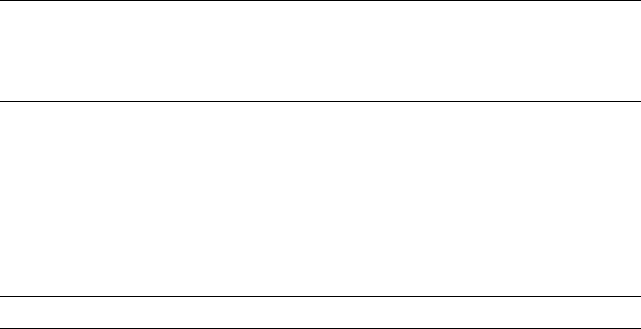
NOTE To delete polygons or elements, select them and press the Delete key. A
dialog might appear asking if you want to delete isolated vertices, which are
vertices that are used only by polygons or elements that are to be deleted. Click
Yes to delete them; click No to retain them.
Insert Vertex Lets you subdivide polygons manually. Applies to polygons,
even if at the element sub-object level.
After turning on Insert Vertex, click a polygon to add a vertex at that location.
You can continue subdividing polygons as long as the command is active.
To stop inserting vertices, right-click in the viewport, or click Insert Vertex
again to turn it off.
NOTE In previous versions of the software, this command was called Divide.
Extrude Lets you perform manual extrusion via direct manipulation in the
viewport. Click this button, and then drag vertically on any polygon to extrude
it.
Extruding polygons moves them along a normal and creates new polygons
that form the sides of the extrusion, connecting the selection to the object.
Following are important aspects of polygon extrusion:
■When over a selected polygon, the mouse cursor changes to an Extrude
cursor.
■Drag vertically to specify the extent of the extrusion, and horizontally to
set the size of the base.
■With multiple polygons selected, dragging on any one extrudes all selected
polygons equally.
■You can drag other polygons in turn to extrude them while the Extrude
button is active. Click Extrude again or right-click in the active viewport
to end the operation.
Editable Poly (Polygon/Element) | 2093
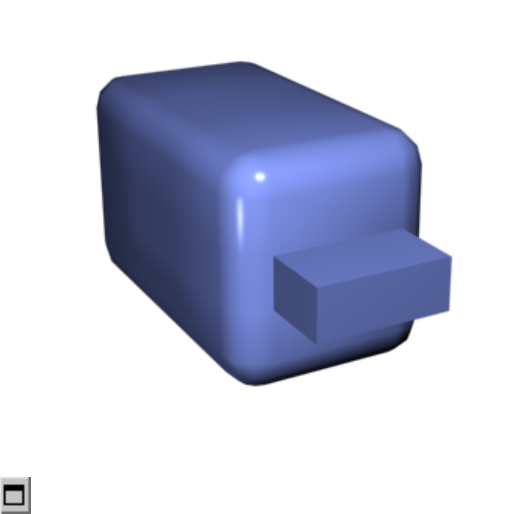
Chamfer box showing extruded polygon
Extrude Settings Opens the Extrude Faces dialog on page 2141 , which
lets you perform extrusion via interactive manipulation.
If you click this button after performing an extrusion, the same extrusion is
performed on the current selection as a preview and the dialog opens with
Extrusion Height set to the amount of the last manual extrusion.
Outline Lets you increase or decrease the outside edge of each contiguous
group of selected polygons.
2094 | Chapter 10 Surface Modeling
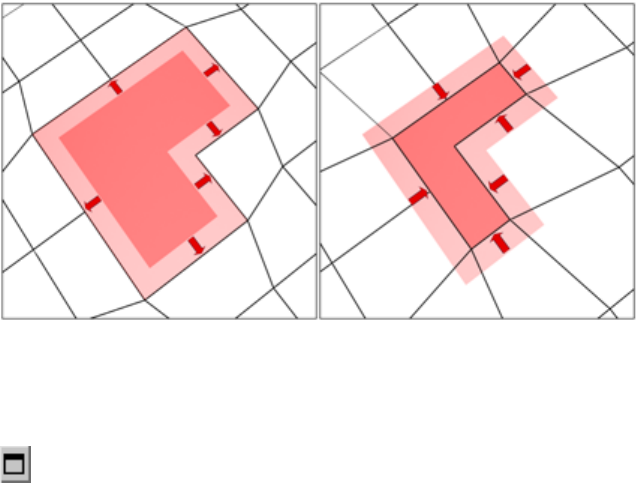
Outline is often used after an extrusion or bevel to adjust the size of the
extruded faces. It doesn't scale the polygons; only changes the size of the outer
edge. For example, in the following illustration, note that the sizes of the inner
polygons remain constant.
Click the Outline Settings button to open the Outline Selected Faces dialog,
which lets you perform outlining by a numeric setting.
Editable Poly (Polygon/Element) | 2095

Extruded polygons (top), outline expanded (middle), outline reduced (bottom)
Note that size of inner polygons doesn't change.
2096 | Chapter 10 Surface Modeling
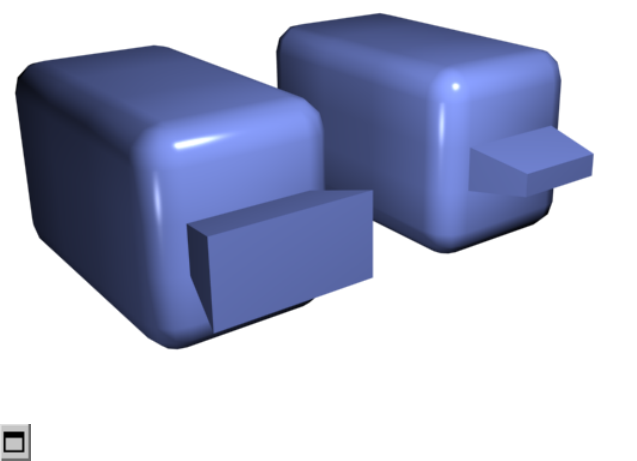
Bevel Lets you perform manual beveling via direct manipulation in the
viewport. Click this button, and then drag vertically on any polygon to extrude
it. Release the mouse button and then move the mouse vertically to outline
the extrusion. Click to finish.
■When over a selected polygon, the mouse cursor changes to a Bevel cursor.
■With multiple polygons selected, dragging on any one bevels all selected
polygons equally.
■You can drag other polygons in turn to bevel them while the Bevel button
is active. Click Bevel again or right-click to end the operation.
Polygon beveled outward (left) and inward (right)
Bevel Settings Opens the Bevel Selection dialog on page 2129 , which lets
you perform beveling via interactive manipulation.
If you click this button after performing a bevel, the same bevel is performed
on the current selection as a preview and the dialog opens with the same
settings used for the previous bevel.
Inset Performs a bevel with no height; that is, within the plane of the polygon
selection. Click this button, and then drag vertically on any polygon to inset
it.
■When over a selected polygon, the mouse cursor changes to an Inset cursor.
Editable Poly (Polygon/Element) | 2097
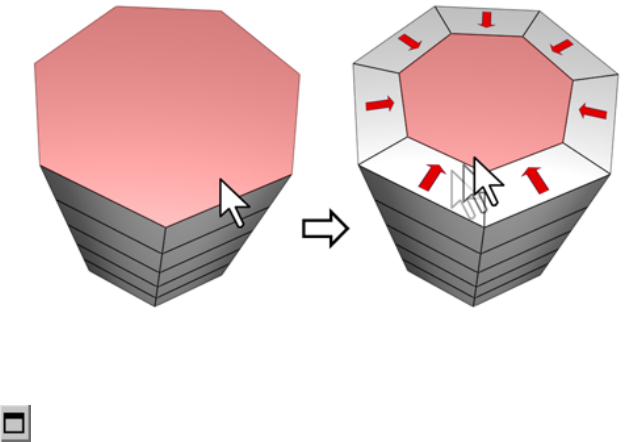
■With multiple polygons selected, dragging on any one insets all selected
polygons equally.
■You can drag other polygons in turn to inset them while the Inset button
is active. Click Inset again or right-click to end the operation.
Inset works on a selection of one or more polygons. As with Outline, only the outer
edges are affected.
Inset Settings Opens the Inset Selected Faces dialog on page 2144 , which
lets you inset polygons via interactive manipulation.
If you click this button after performing a manual inset, the same inset is
performed on the current selection as a preview and the dialog opens with
Inset Amount set to the amount of the last manual inset.
Bridge Connects two polygons or polygon selections on an object with a
polygon “bridge.” There are two ways to use Bridge in Direct Manipulation
mode (that is, without opening the Bridge Settings dialog):
■Make two separate polygon selections on the object, and then click Bridge.
This creates the bridge immediately using the current Bridge settings, and
then deactivates the Bridge button.
■If no qualifying selection exists (that is, two or more discrete polygon
selections), clicking Bridge activates the button and places you in Bridge
mode. First click a polygon and move the mouse; a rubber-band line
connects the mouse cursor to the clicked polygon. Click a second polygon
to bridge the two. This creates the bridge immediately using the current
2098 | Chapter 10 Surface Modeling
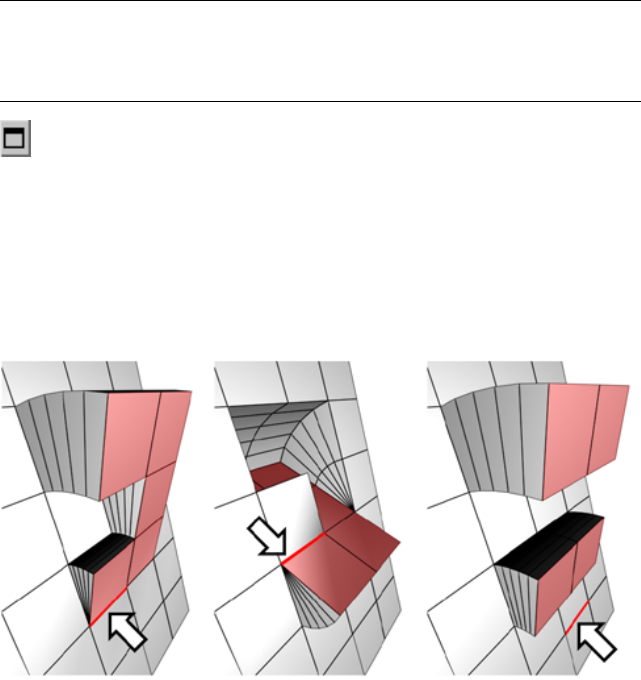
Bridge settings; the Bridge button remains active for connecting more pairs
of polygons. To exit Bridge mode, right-click the active viewport or click
the Bridge button.
NOTE Bridge always creates a straight-line connection between polygon pairs.
To make the bridge connection follow a contour, apply modeling tools as
appropriate after creating the bridge. For example, bridge two polygons, and
then use Bend on page 1139 .
Bridge Settings Opens the Bridge dialog on page 2131 , which lets you
connect pairs of polygon selections via interactive manipulation.
Flip Reverses the directions of the normals of selected polygons, hence their
facing.
Hinge From Edge Lets you perform a manual hinge operation via direct
manipulation in the viewport. Make a polygon selection, click this button,
and then drag vertically on any edge to hinge the selection. The mouse cursor
changes to a cross when over an edge.
The hinge edge needn't be part of the selection. It can be any edge of the mesh. Also,
the selection needn't be contiguous.
Hinging polygons rotates them about an edge and creates new polygons that
form the sides of the hinge, connecting the selection to the object. It's
essentially an extrusion with rotation, with the exception that, if the hinge
edge belongs to a selected polygon, that side is not extruded. The manual
version of Hinge From Edge works only with an existing polygon selection.
Editable Poly (Polygon/Element) | 2099
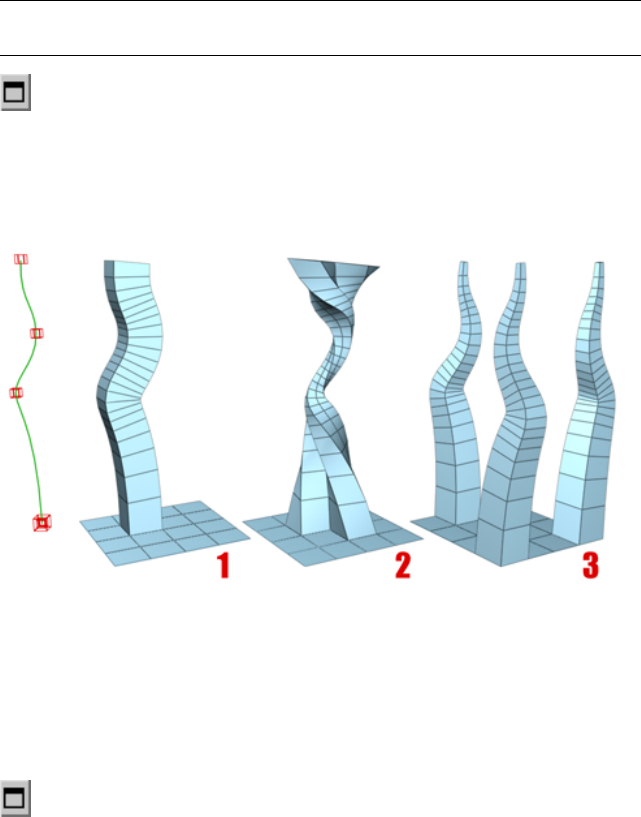
TIP Turn on Ignore Backfacing to avoid inadvertently hinging about a backfacing
edge.
Hinge Settings Opens the Hinge From Edge dialog on page 2143 , which
lets you hinge polygons via interactive manipulation.
If you click this button after performing a manual hinge, the dialog opens
with Angle set to the extent of the last manual hinge.
Extrude Along Spline Extrudes the current selection along a spline.
You can extrude a single face (1) or a selection of contiguous (2) or non-contiguous
faces (3). Extrusion 2 uses Taper Curve and Twist. Extrusion 3 uses Taper Amount; each
extrusion has a different curve rotation.
Make a selection, click this button, and the select a spline in the scene. The
selection is extruded along the spline, using the spline's current orientation,
but as though the spline's start point were moved to the center of each polygon
or group.
Extrude Along Spline Settings Opens the Extrude Polygons Along Spline
dialog on page 2139 , which lets you extrude along splines via interactive
manipulation.
Edit Triangulation Lets you modify how polygons are subdivided into
triangles by drawing internal edges.
2100 | Chapter 10 Surface Modeling
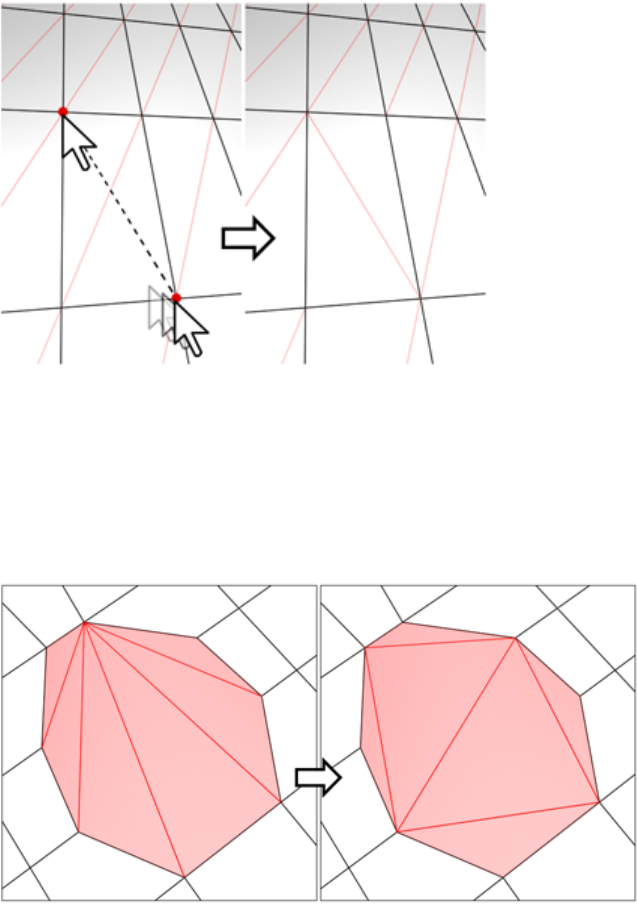
In Edit Triangulation mode, you can see the current triangulation in the viewport, and
change it by clicking two vertices on the same polygon.
To manually edit triangulation, turn on this button. The hidden edges appear.
Click a polygon vertex. A rubber-band line appears, attached to the cursor.
Click a non-adjacent vertex to create a new triangulation for the polygon.
Retriangulate Lets the software automatically do its best triangulation on
the polygon or polygons currently selected.
Retriangulate attempts to optimize how selected polygons are subdivided into triangles.
Editable Poly (Polygon/Element) | 2101
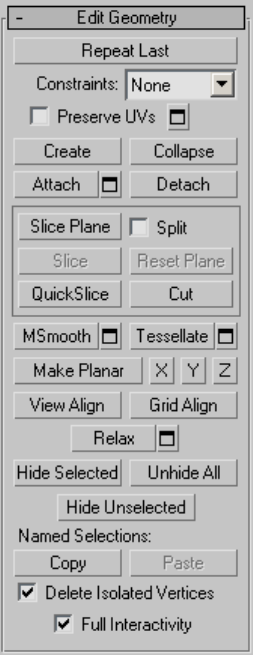
Turn Lets you modify how polygons are subdivided into triangles by clicking
diagonals. When you activate Turn, the diagonals on page 7757 become visible
as dashed lines in wireframe and edged-faces views. In Turn mode, click a
diagonal to change its position. To exit Turn mode, right-click in the viewport
or click the Turn button again.
Each diagonal has only two available positions at any given time, so clicking
a diagonal twice in succession simply returns it to its original position. But
changing the position of a nearby diagonal can make a different alternate
position available to a diagonal.
For more information on how to use Turn with the enhanced Cut tool, see
this procedure on page ? .
Edit Geometry rollout
2102 | Chapter 10 Surface Modeling
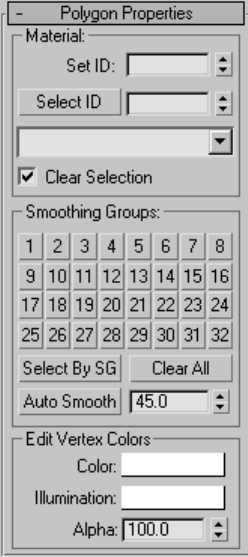
See Edit Geometry Rollout (Polymesh) on page 2105 for detailed descriptions
of these controls.
Polygon Properties rollout
These controls let you work with material IDs, smoothing groups, and vertex
colors.
Material group
Set ID Lets you assign a particular material ID on page 7842 number to selected
sub-objects for use with multi/sub-object materials on page 5558 and other
applications. Use the spinner or enter the number from the keyboard. The
total number of available IDs is 65,535.
Select ID Selects sub-objects corresponding to the Material ID specified in
the adjacent ID field. Type or use the spinner to specify an ID, then click the
Select ID button.
Editable Poly (Polygon/Element) | 2103

[Select By Name] This drop-down list shows the names of sub-materials if
an object has a Multi/Sub-Object material assigned to it. Click the drop arrow
and choose a sub-material from the list. The sub-objects that are assigned that
material are selected. If an object does not have a Multi/Sub-Object material
assigned, the name list is unavailable. Likewise, if multiple objects are selected
that have an Edit Patch, Edit Spline, or Edit Mesh modifier applied, the name
list is inactive.
NOTE Sub-material names are those specified in the Name column on the
material's Multi/Sub-Object Basic Parameters rollout; these are not created by
default, and must be specified separately from any material names.
Clear Selection When on, choosing a new ID or material name deselects any
previously selected sub-objects. When off, selections are cumulative, so new
ID or sub-material name selections add to the existing selection set of patches
or elements. Default=on.
Smoothing Groups group
Use these controls to assign selected polygons to different smoothing groups
on page 7932 , and to select polygons by smoothing group.
To assign polygons to one or more smoothing groups, select the polygons,
and then click the number(s) of the smoothing group(s) to assign them to.
Select By SG (Smoothing Group) Displays a dialog that shows the current
smoothing groups. Select a group by clicking the corresponding numbered
button and clicking OK. If Clear Selection is on, any previously selected
polygons are first deselected. If Clear Selection is off, the new selection is
added to any previous selection set.
Clear All Removes any smoothing group assignments from selected polygons.
Auto Smooth Sets the smoothing groups based on the angle between
polygons. Any two adjacent polygons will be put in the same smoothing group
if the angle between their normals is less than the threshold angle, set by the
spinner to the right of this button.
Threshold This spinner (to the right of Auto Smooth) lets you specify the
maximum angle between the normals of adjacent polygons that determines
whether those polygons will be put in the same smoothing group.
Edit Vertex Colors group
Use these controls to assign the color, illumination color (shading), and alpha
(transparency) values of vertices on selected polygons or elements.
2104 | Chapter 10 Surface Modeling
Color Click the color swatch to change the color of vertices on selected
polygons or elements.
Illumination Click the color swatch to change the illumination color of
vertices on selected polygons or elements. This lets you change the illumination
without changing the vertex's color.
Alpha Lets you assign an alpha (transparency) value to vertices on selected
polygons or elements.
The spinner value is a percentage; zero is completely transparent and 100 is
completely opaque.
Subdivision Surface rollout
See Interface on page 2119 for information on the Subdivision Surface rollout
settings.
Subdivision Displacement rollout
See Interface on page 2124 for information on the Subdivision Displacement
rollout settings.
Paint Deformation rollout
Paint Deformation lets you stroke elevated and indented areas directly onto
object surfaces. For more information, see Paint Deformation Rollout on page
2125 .
Edit Geometry Rollout (Polymesh)
Create or select an editable poly object. > Modify panel > Edit Geometry rollout
The Edit Geometry rollout provides global controls for changing the geometry
of the polymesh, at either the top (Object) level or the sub-object levels. The
control are the same at all levels, except as noted in the descriptions below.
Edit Geometry Rollout (Polymesh) | 2105
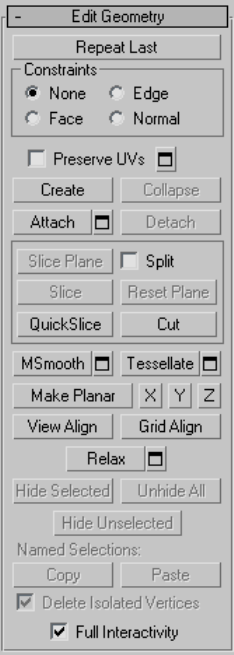
Interface
Repeat Last Repeats the most recently used command.
For example, if you extrude a polygon, and want to apply the same extrusion
to several others, select the others, and then click Repeat Last.
2106 | Chapter 10 Surface Modeling
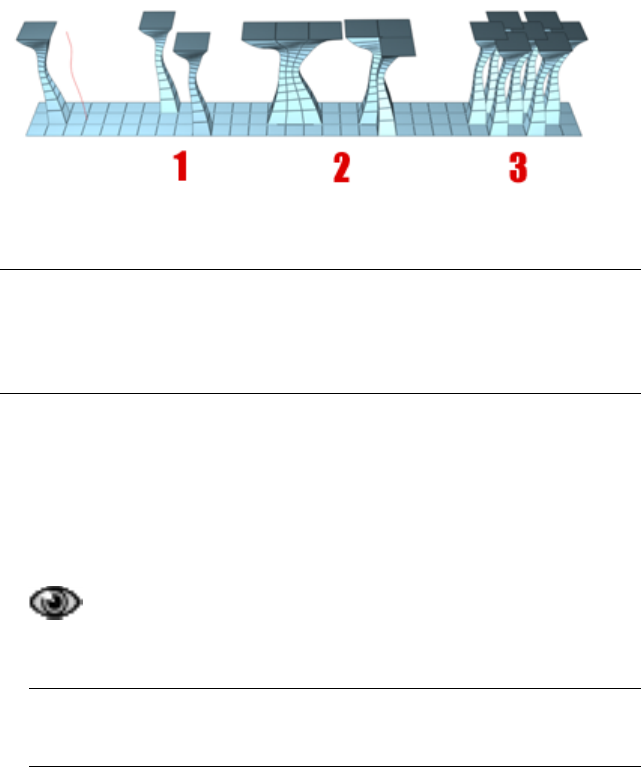
You can apply a spline extrusion of a single polygon (left) repeatedly to other single
polygons (1) or to multiple polygon selections, contiguous (2) or not (3).
NOTE Repeat Last does not repeat all operations. For example, it does not repeat
transforms. To determine which command will be repeated when you click the
button, check the button's tooltip, which gives the name of the last operation that
can be repeated. If no tooltip appears, nothing will happen when you click the
button.
Constraints Lets you use existing geometry to constrain sub-object
transformation. Choose the constraint type:
■None: No constraints. This is the default option.
■Edge: Constrains sub-object transformations to edge boundaries.
■Face: Constrains sub-object transformations to individual face surfaces.
■Normal: Constrains each sub-object’s transformations to its normal,
or the average of its normals. In most cases, this causes sub-objects to move
perpendicular to the surface.
NOTE This constraint works like the Push modifier on page 1574 , including the
fact that it operates on unmodified base normals. Edited normals are
unsupported.
Edit Geometry Rollout (Polymesh) | 2107
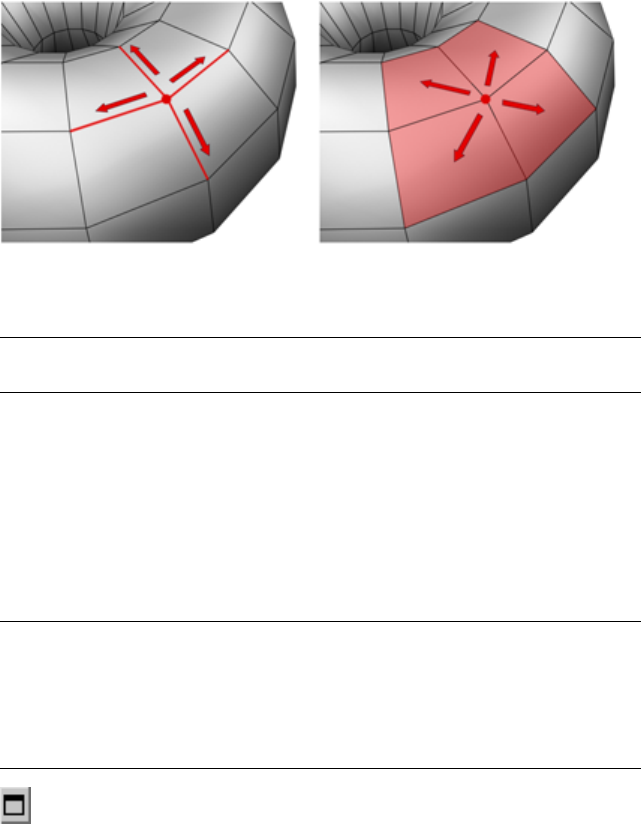
When set to Edge, moving a vertex will slide it along one of the existing edges,
depending on the direction of the transformation. If set to Face, the vertex moves only
on the polygon’s surface.
NOTE You can set constraints at the Object level, but their use pertains primarily
to sub-object levels. The Constraints setting persists at all sub-object levels.
Preserve UVs When on, you can edit sub-objects without affecting the object's
UV mapping. You can choose any of an object's mapping channels to preserve
or not; see Preserve UVs Settings, following. Default=off.
Without Preserve UVs, there is always a direct correspondence between an
object's geometry and its UV mapping. For example, if you map an object and
then move vertices, the texture moves along with the sub-objects, whether
you want it to or not. If you turn on Preserve UVs, you can perform minor
editing tasks without changing the mapping.
TIP For best results with Preserve UVs at the vertex level, use it for limited vertex
editing. For example, you'll usually have no trouble moving a vertex within edge
or face constraints. Also, it's better to perform one big move than several smaller
moves, as multiple small moves can begin to distort the mapping. If, however,
you need to perform extensive geometry editing while preserving mapping, use
the Channel Info utility on page 5858 instead.
Preserve UVs Settings Opens the Preserve Map Channels dialog on page
2146 , which lets you specify which vertex color channels and/or texture channels
(map channels) to preserve. By default, all vertex color channels are off (not
preserved), and all texture channels are on (preserved).
2108 | Chapter 10 Surface Modeling
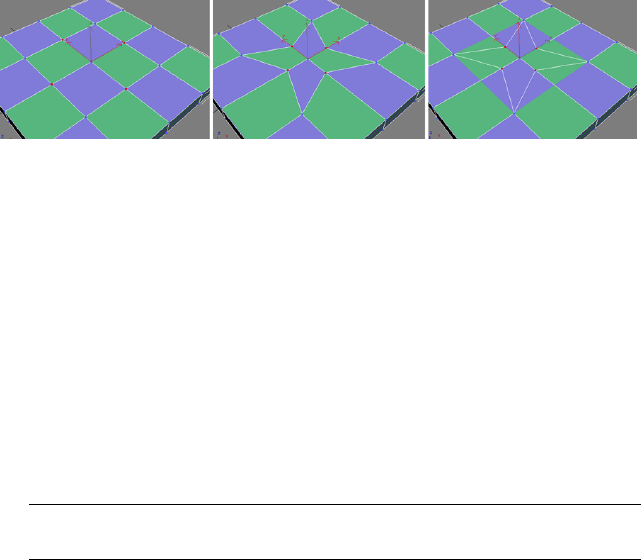
Original object with texture map (left); Scaled vertices with Preserve UVs off (center);
Scaled vertices with Preserve UVs on (right)
Create Lets you create new geometry. How this button behaves depends on
which level is active:
■Object, Polygon, and Element levels Lets you add polygons in the active
viewport. After you turn on Create, click three or more times in succession
anywhere, including on existing vertices, to define the shape of the new
polygon. To finish, right-click.
While creating a polygon at the Polygon or Element level, you can delete
the most recently added vertex by pressing Backspace. You can do this
repeatedly to remove added vertices in reverse order of placement.
You can start creating polygons in any viewport, but all subsequent clicks
must take place in the same viewport.
TIP For best results, click vertices in counterclockwise (preferred) or clockwise
order. If you use clockwise order, the new polygon will face away from you.
■Vertex level Lets you add vertices to a single selected poly object. After
selecting the object and clicking Create, click anywhere in space to add
free-floating (isolated) vertices to the object. The new vertices are placed
on the active construction plane unless object snapping is on. For example,
with face snapping on, you can create vertices on object faces.
■Edge and Border levels Lets you create an edge between a pair of
non-adjacent vertices on the same polygon. Click Create, click a vertex,
and then move the mouse. A rubber-band line extends from the vertex to
the mouse cursor. Click a second, non-adjacent vertex on the same polygon
to connect them with an edge. Repeat, or, to exit, right-click in the viewport
or click Create again.
Edges you create separate the polygons. For example, by creating an edge
inside a quadrilateral polygon, you turn it into two triangles.
Collapse (Vertex, Edge, Border, and Polygon levels only) Collapses groups
of contiguous selected sub-objects by welding their vertices to a vertex at the
selection center.
Edit Geometry Rollout (Polymesh) | 2109

Attach Lets you attach another object in the scene to the selected editable
poly. You can attach any type of object, including splines, patch objects, and
NURBS surfaces. Attaching a non-mesh object converts it to editable-poly
format. Click the object you want to attach to the currently selected poly
object.
When you attach an object, the materials of the two objects are combined in
the following way:
■If the object being attached does not have a material assigned, it inherits
the material of the object it is being attached to.
■Likewise, if the object you're attaching to doesn't have a material, it inherits
the material of the object being attached.
■If both objects have materials, the resulting new material is a
multi/sub-object material on page 5558 that includes the input materials.
A dialog appears offering three methods of combining the objects' materials
and material IDs. For more information, see Attach Options Dialog on
page 2031 .
Attach remains active in all sub-object levels, but always applies to objects.
Attach List Lets you attach other objects in the scene to the selected
mesh. Click to open the Attach List dialog, which works like Select From
Scene on page 168 to let you choose multiple objects to attach.
2110 | Chapter 10 Surface Modeling
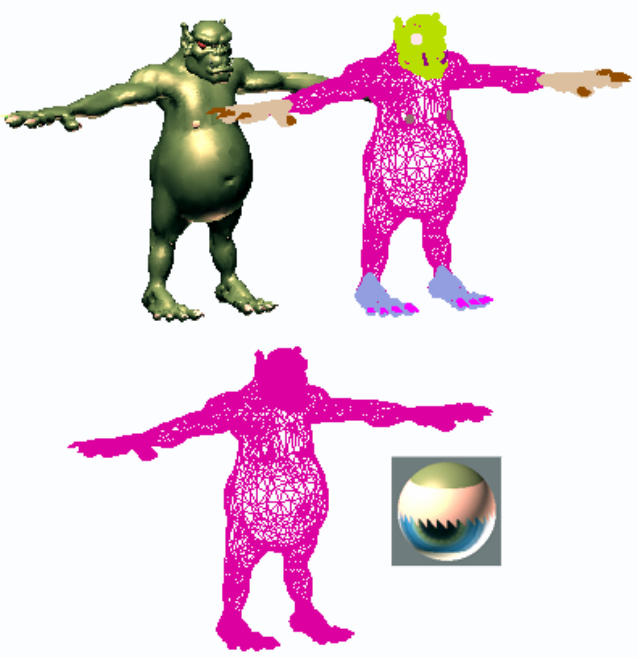
Shaded view of model (upper left); wireframe view of model (upper right); model with
objects attached (lower left); and subsequent multi/sub-object material (lower right)
Detach (sub-object levels only) Detaches the selected sub–objects and the
polygons attached to them as a separate object or element. The Detach As
Clone option copies the sub-objects rather than moving them.
You're prompted to enter a name for the new object. Detached faces leave a
hole in the original object when you move them to a new position, unless
you use the Detach As Clone option.
Cut and Slice group
These knife-like tools let you subdivide the poly mesh along a plane (Slice) or
in a specific area (Cut). Also see Full Interactivity on page 2117 .
Edit Geometry Rollout (Polymesh) | 2111
Slice Plane (sub-object levels only) Creates a gizmo for a slice plane that you
can position and rotate to specify where to slice. Also enables the Slice and
Reset Plane buttons.
If snapping is turned off, you see a preview of the slice as you transform the
slice plane. To perform the slice, click the Slice button.
Split When on, the QuickSlice and Cut operations create double sets of
vertices at the points where the edges are divided. This lets you easily delete
the new polygons to create holes, or animate the new polygons as separate
elements.
Slice (sub-object levels only) Performs the slice operation at the location of
the slice plane. Available only when Slice Plane is on. This tool slices the poly
just like the “Operate On: Polygons” mode of the Slice modifier on page 1658
.
Reset Plane (sub-object levels only) Returns the Slice plane to its default
position and orientation. Available only when Slice Plane is on.
QuickSlice Lets you quickly slice the object without having to manipulate
a gizmo. Make a selection, click QuickSlice, and then click once at the slice
start point and again at its endpoint. You can continue slicing the selection
while the command is active.
To stop slicing, right-click in the viewport, or click QuickSlice again to turn
it off.
2112 | Chapter 10 Surface Modeling
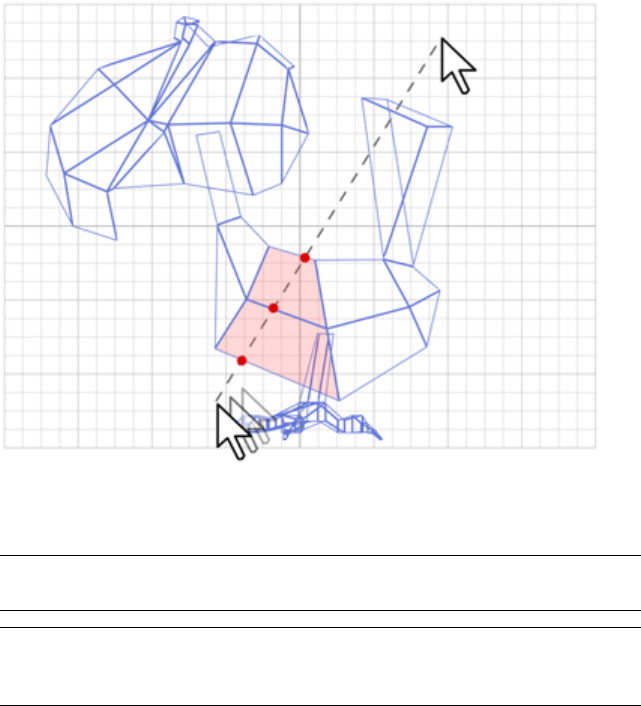
With Quickslice on, you can draw a line across your mesh in any viewport, including
Perspective and Camera views. The mesh is sliced interactively as you move the line
endpoint.
NOTE At the Object level, QuickSlice affects the entire object. To slice only specific
polygons, use QuickSlice on a polygon selection at the Poly sub-object level.
NOTE At the Polygon or Element sub-object level, QuickSlice affects only selected
polygons. To slice the entire object, use QuickSlice at any other sub-object level,
or at the object level.
Cut Lets you create edges from one polygon to another or within polygons.
Click at the start point, move the mouse and click again, and continue moving
and clicking to create new connected edges. Right-click once to exit the current
cut, whereupon you can start a new one, or right-click again to exit Cut mode.
Edit Geometry Rollout (Polymesh) | 2113
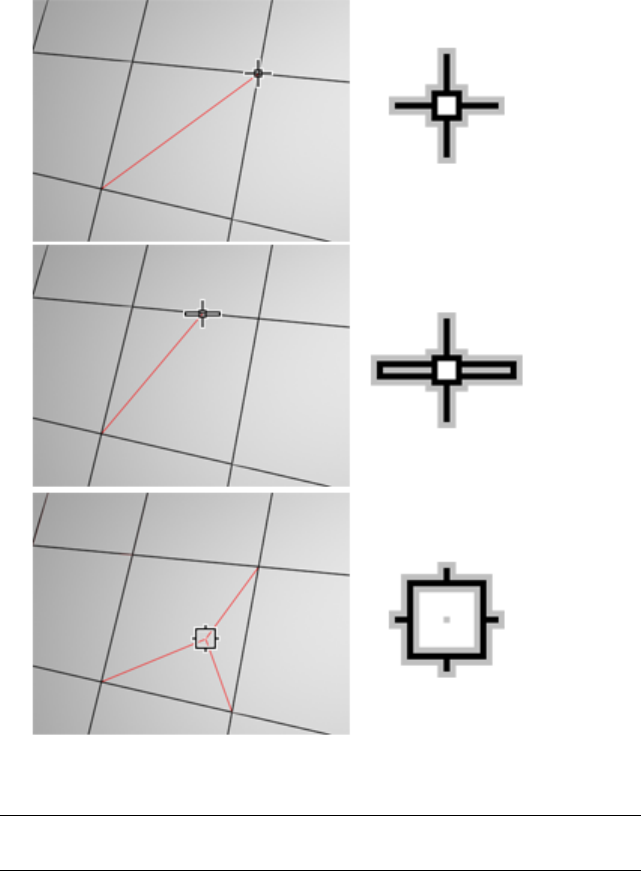
Cutting to a vertex (top); cutting an edge (center); cutting a polygon (bottom). Cut
is available at the object level and all sub-object levels.
NOTE You can use Cut with Turn for enhanced productivity. For more information,
see this procedure on page ? .
MSmooth Smoothes the object using the current settings. This command
uses subdivision functionality similar to that of the MeshSmooth modifier
on page 1460 with NURMS Subdivision, but unlike NURMS Subdivision, it
applies the smoothing instantly to the selected area of the control mesh.
2114 | Chapter 10 Surface Modeling
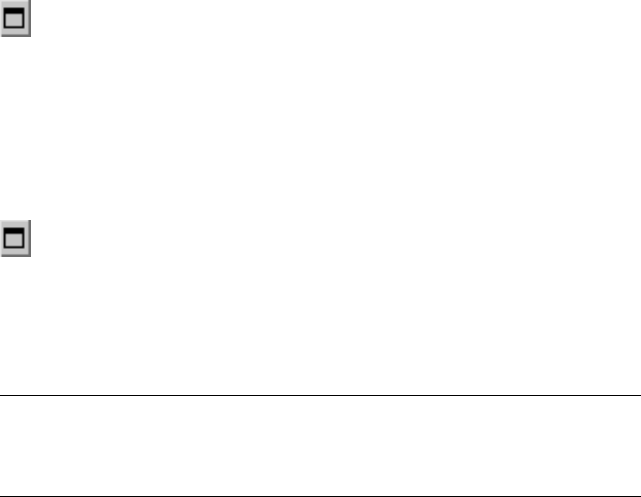
MSmooth Settings Opens the MeshSmooth Selection dialog on page
2145 , which lets you specify how smoothing is applied.
Tessellate Subdivides all polygons in the object based on the Tessellation
settings on page 2149 .
Tessellation is useful for increasing local mesh density while modeling. You
can subdivide any selection of polygons. Two tessellation methods are
available: Edge and Face.
Tessellate Settings Opens the Tessellate Selection dialog on page 2149 ,
which lets you specify how smoothing is applied.
Make Planar Forces all selected sub-objects to be coplanar. The plane's normal
is the average surface normal of the selection.
At the Object level, forces all vertices in the object to become coplanar.
TIP One application for Make Planar is making a flat side on an object. Normally,
you would use a contiguous selection set. If the selection includes vertices on
various parts of the object, the vertices are still made planar, but with distorting
effects on the rest of the geometry.
X/Y/Z Makes all selected sub-objects planar and aligns the plane with the
corresponding plane in the object's local coordinate system. The plane used
is the one to which the button axis is perpendicular; so, for example, clicking
the X button aligns the object with the local YZ axis.
At the Object level, makes all vertices in the object planar.
View Align Aligns all vertices in the object to the plane of the active viewport.
If a sub-object mode is active, this function affects only selected vertices or
those belonging to selected sub-objects. In the case of orthographic viewports,
using View Align has the same effect as aligning to the construction grid when
the home grid is active. When aligning to a perspective viewport (including
camera and light views), the vertices are reoriented to be aligned to a plane
that is parallel to the camera's viewing plane. This plane is perpendicular to
the view direction that is closest to the vertices' average position.
Edit Geometry Rollout (Polymesh) | 2115
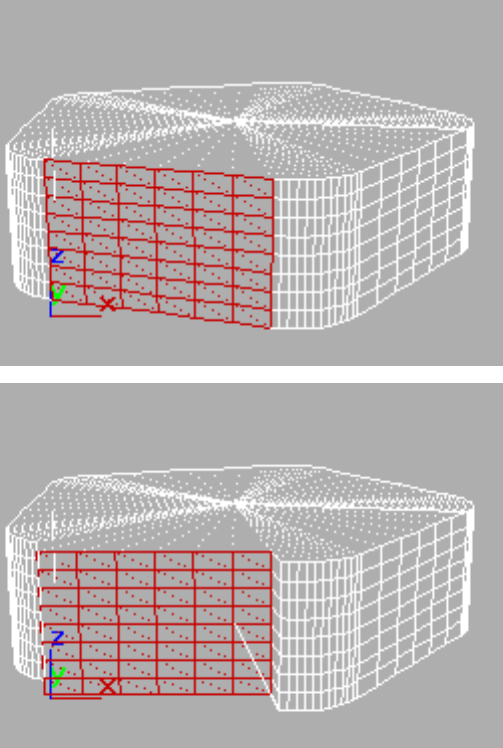
Above: Selected polygons in Perspective view
Below: Same polygons aligned to Front view
Grid Align Aligns all vertices in the selected object to the plane of the current
view. If a sub-object mode is active, function aligns only selected sub-objects.
This function aligns the selected vertices to the current construction plane.
The current plane is specified by the active viewport in the case of the home
grid. When using a grid object, the current plane is the active grid object.
Relax Applies the Relax function to the current selection, using the Relax
dialog settings (see following). Relax normalizes mesh spacing by moving each
2116 | Chapter 10 Surface Modeling
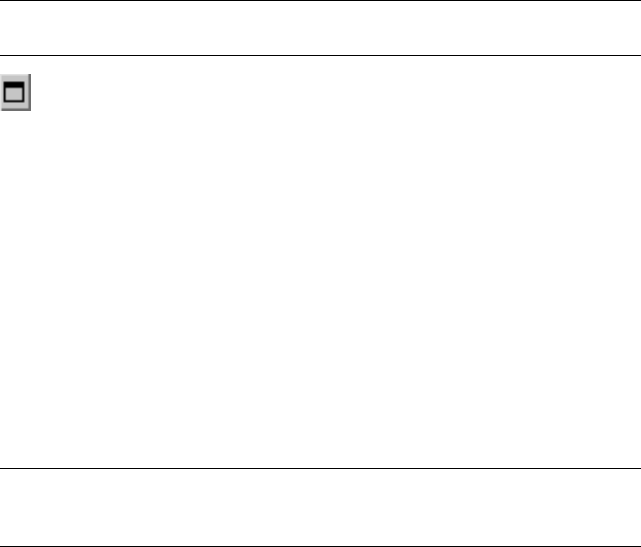
vertex toward the average location of its neighbors. It works the same way as
the Relax modifier on page 1575 .
NOTE At the object level, Relax applies to the entire object. At any sub-object
level, Relax applies only to the current selection.
Relax Settings Opens the Relax dialog on page 2148 , which lets you
specify how the Relax function is applied.
Hide Selected (Vertex, Polygon, and Element levels only) Hides any selected
sub-objectgs.
Unhide All (Vertex, Polygon, and Element levels only) Restores any hidden
sub-objects to visibility.
Hide Unselected (Vertex, Polygon, and Element levels only) Hides any
unselected sub-objects.
Named Selections (sub-object levels only)
Lets you copy and paste named selection sets of sub-objects between objects.
Start by creating one or more named selection sets, copy one, select a different
object, go to the same sub-object level, and then paste the set.
NOTE This function uses sub-object IDs, so if the target object's geometry differs
from that of the source object, the pasted selection will probably comprise a
different set of sub-objects.
For more information, see Named Selection Sets on page 146 .
Copy Opens a dialog that lets you specify a named selection set to place into
the copy buffer.
Paste Pastes the named selection from the copy buffer.
Delete Isolated Vertices (Edge, Border, Polygon, and Element levels
only) When on, deletes isolated vertices when you delete a selection of
contiguous sub-objects. When off, deleting sub-objects leaves all vertices intact.
Default=on.
Full Interactivity Toggles the level of feedback for the QuickSlice and Cut
tools, as well as all settings dialogs.
When on (the default), the final result is always visible as you use the mouse
to manipulate the tool or change a numeric setting. With Cut and QuickSlice,
when Full Interactivity is turned off, only the rubber-band line is visible until
Edit Geometry Rollout (Polymesh) | 2117
you click. Similarly, with numeric settings in dialogs, the final result is visible
only when you release the mouse button after changing the setting.
The state of Full Interactivity doesn't affect changing a numeric setting from
the keyboard. Whether it's on or off, the setting takes effect only when you
exit the field by pressing Tab or Enter, or by clicking a different control in the
dialog.
Subdivision Surface Rollout (Polymesh)
Create or select an editable poly object. > Modify panel > Subdivision Surface
rollout
Applies subdivision to the object in the style of MeshSmooth on page 1460 , so
you can work on a lower-resolution "cage" mesh and simultaneously see a
smoother, subdivided result. This rollout is available at all sub-object levels,
as well as at the object level, and always affects the entire object.
2118 | Chapter 10 Surface Modeling
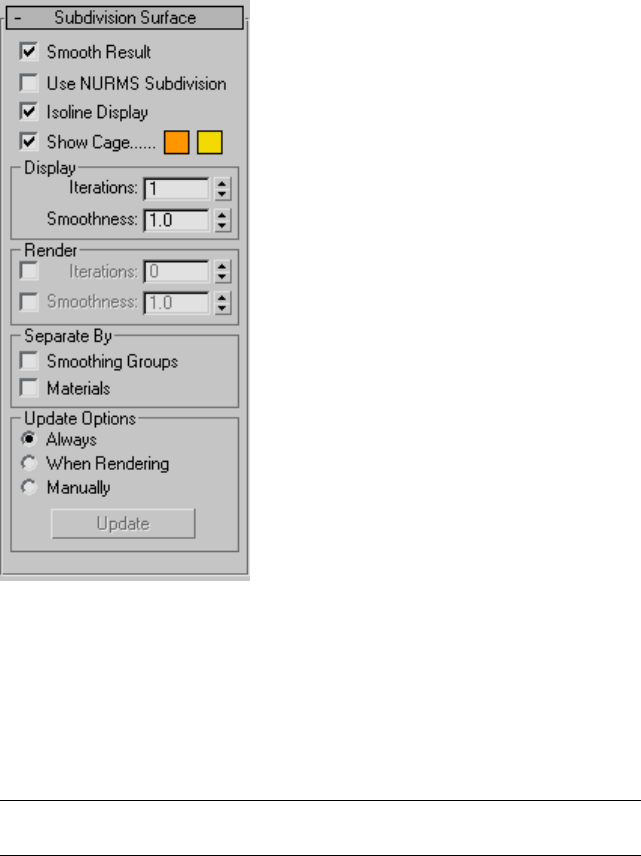
Interface
Smooth Result Applies the same smoothing group to all polygons.
Use NURMS Subdivision Applies smoothing via the NURMS method. See
NURMS on page 1463 . The difference between NURMS in Editable Poly and
MeshSmooth is that the latter gives you access to control vertices, but the
former does not.
You control the degree of smoothing with the Iterations controls in the Display
and Render groups.
NOTE The remaining controls on this rollout take effect only when Use NURMS
Subdivision is on.
Isoline Display When on, the software displays only isolines: the object's
original edges, before smoothing. The benefit of using this option is a less
cluttered display. When off, the software displays all faces added by NURMS
Subdivision Surface Rollout (Polymesh) | 2119
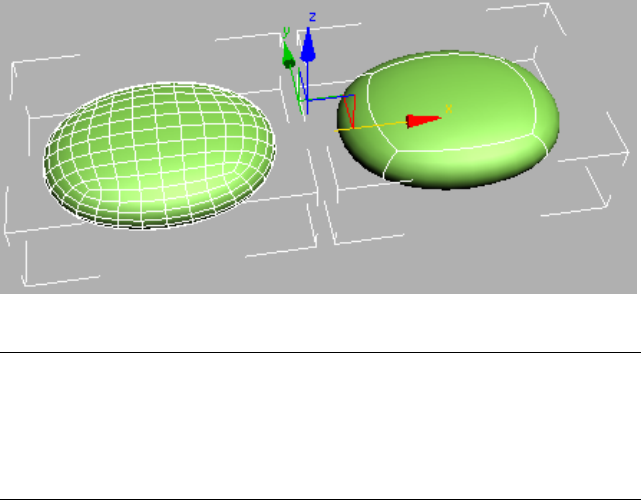
Subdivision; thus, higher Iterations settings (see Display group on page 2121 )
result in a greater number of lines. Default=on.
Smoothed box with Isoline Display off (left) and Isoline Display on (right).
NOTE Applying a modifier to an Editable Poly object cancels the effect of the
Isoline Display option; the wireframe display reverts to showing all polygons in
the object. This is not, however, always the case with the MeshSmooth modifier.
Most deformation and mapping modifiers maintain the isoline display, but others,
such as the selection modifiers (except Volume Select) and the Turn To ... modifiers,
cause the interior edges to be displayed.
Show Cage Toggles the display of a two-color wireframe that shows the
editable poly object before modification or subdivision. The cage colors are
shown as swatches to the right of the check box. The first color represents
unselected sub-objects, and the second color represents selected sub-objects.
Change a color by clicking its swatch.
2120 | Chapter 10 Surface Modeling
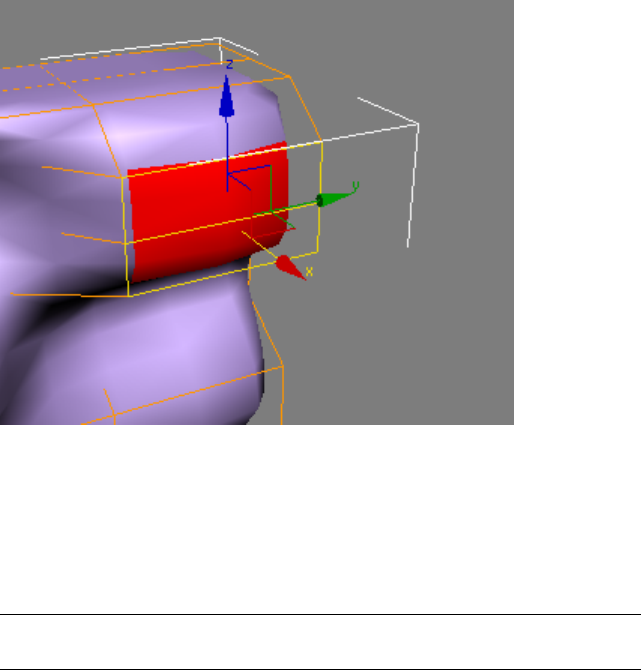
The cage displays the original structure of the edited object.
Typically this feature is used in conjunction with the NURMS Subdivision
feature, or with the MeshSmooth modifier on page 1460 , because it lets you
easily toggle visibility of the unsmoothed base object while simultaneously
viewing the smoothed result, but it works with any modifier. When used with
a modifier, turn on Show End Result to make Show Cage available.
TIP Show Cage is particularly helpful when used with the Symmetry modifier on
page 1735 .
Display group
Iterations Sets the number of iterations used to smooth the poly object. Each
iteration generates all polygons using the vertices created from the previous
iteration. Range=0 to 10.
When the Iterations check box in the Render group (see below) is off, this
setting controls iterations both in the viewports and at render time. When
the check box is on, this setting controls iterations only in the viewports.
Subdivision Surface Rollout (Polymesh) | 2121
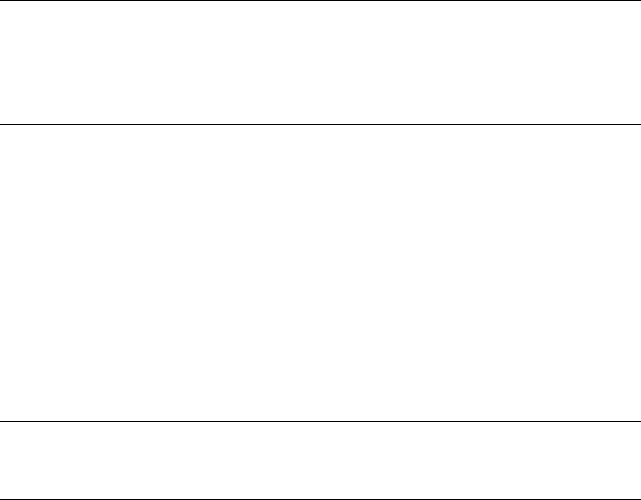
TIP Use caution when increasing the number of iterations. The number of vertices
and polygons in an object (and thus the calculation time) can increase as much
as four times for each iteration. Applying four iterations to even a moderately
complex object can take a long time to calculate. You can press Esc to stop
calculation and revert to the previous iteration setting.
Smoothness Determines how sharp a corner must be before polygons are
added to smooth it. A value of 0.0 prevents the creation of any polygons. A
value of 1.0 adds polygons to all vertices even if they lie on a plane.
When the Smoothness check box in the Render group (see below) is off, this
setting controls smoothness both in the viewports and at render time. When
the check box is on, this setting controls smoothness only in the viewports.
Render group
Applies a different number of smoothing iterations and/or a different
Smoothness value to the object at render time.
TIP Use a low number of iterations and/or a lower Sharpness value for modeling,
and higher values for rendering. This lets you work quickly with a low-resolution
object in the viewports, while producing a smoother object for rendering.
Iterations Lets you choose a different number of smoothing iterations to be
applied to the object at render time. Turn on Iterations, and then use the
spinner to its right to set the number of iterations.
Smoothness Lets you choose a different Smoothness value to be applied to
the object at render time. Turn on Smoothness, and then use the spinner to
its right to set the smoothness value.
Separate By group
Smoothing Groups Prevents the creation of new polygons at edges between
faces that don't share at least one smoothing group.
Materials Prevents the creation of new polygons for edges between faces
that do not share Material IDs.
Update Options group
Sets manual or render-time update options, for situations where the complexity
of the smoothed object is too high for automatic updates. Note that you can
also choose Iterations under the Render group to set a greater degree of
smoothing to be applied only at render time.
2122 | Chapter 10 Surface Modeling

Always Updates the object automatically whenever you change any
MeshSmooth settings.
When Rendering Updates the viewport display of the object only at render
time.
Manually Turns on manual updating. When manual updating is selected,
any settings you change don't take effect until you click the Update button.
Update Updates the object in the viewport to match the current MeshSmooth
settings. Works only when you choose When Rendering or Manually.
Subdivision Displacement Rollout (Polymesh)
Create or select an editable poly object. > Modify panel > Subdivision
Displacement rollout
Specifies surface approximation settings for subdividing the editable poly.
These controls work like the surface approximation settings for NURBS on
page 2152 surfaces. They are used when you apply a displacement map on page
5391 to the editable poly.
NOTE These settings differ from the Subdivision Surface settings in that, while
the latter are applied at the same modifier-stack level as the mesh, subdivision
displacement is always applied at the top of the stack, when the mesh is used for
rendering. Thus, a Symmetry modifier applied to an object using surface subdivision
would affect the subdivided mesh, but would not affect an object that uses
subdivision displacement only.
Subdivision Displacement Rollout (Polymesh) | 2123
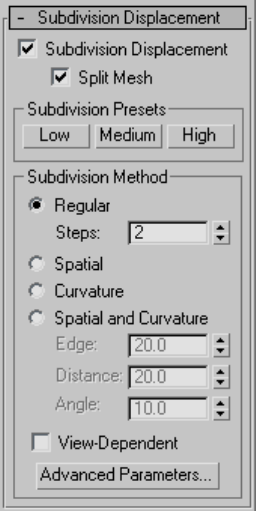
Interface
Subdivision Displacement When on, polygons are subdivided to accurately
displace the poly object, using the method and settings you specify in the
Subdivision Presets and Subdivision Method group boxes. When off, the poly
is displaced by moving existing vertices, the way the Displace modifier on
page 1274 does. Default=off.
Split Mesh Affects the seams of displaced poly objects; also affects texture
mapping. When on, the poly object is split into individual polygons before
it is displaced; this helps preserve texture mapping. When off, the poly is not
split and an internal method is used to assign texture mapping. Default=on.
2124 | Chapter 10 Surface Modeling
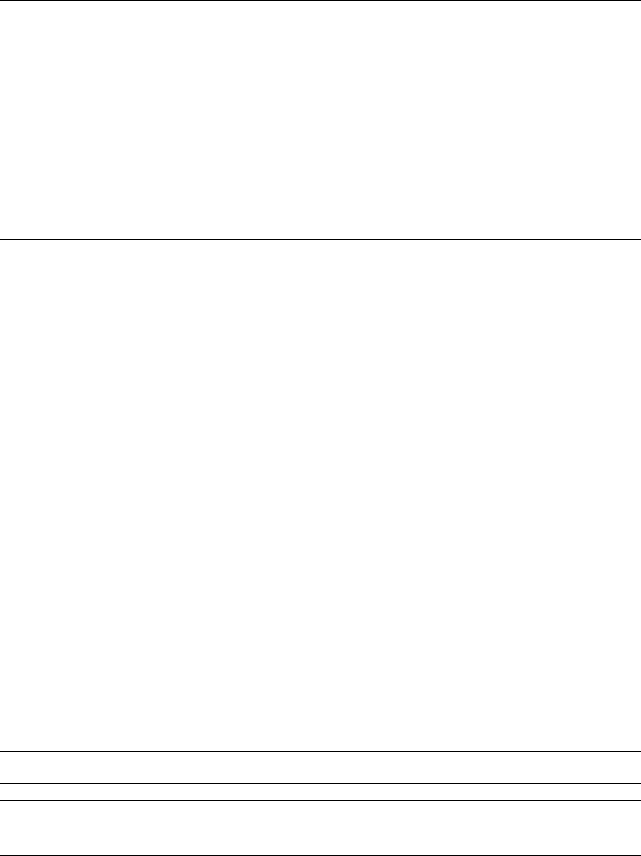
TIP This parameter is required because of an architectural limitation in the way
displacement mapping works. Turning Split Mesh on is usually the better technique,
but it can cause problems for objects with clearly distinct faces, such as boxes, or
even spheres. A box's sides might separate as they displace outward, leaving gaps.
And a sphere might split along its longitudinal edge (found in the rear for spheres
created in the Top view) unless you turn off Split Mesh. However, texture mapping
works unpredictably when Split Mesh is off, so you might need to add a Displace
Mesh modifier on page 1045 and make a snapshot on page 921 of the poly. You
would then apply a UVW Map modifier on page 1849 and then reassign mapping
coordinates to the displaced snapshot poly.
Subdivision Presets group & Subdivision Method group
The controls in these two group boxes specify how the program applies the
displacement map when Subdivision Displacement is on. They are identical
to the Surface Approximation controls on page 2469 used for NURBS surfaces.
Paint Deformation Rollout
Edit/Editable Poly object > Paint Deformation rollout
Paint Deformation lets you push, pull, or otherwise affect vertices by dragging
the mouse cursor over the object surface. At the object level, Paint Deformation
affects all vertices in the selected object. At sub-object levels, it affects only
selected vertices (or vertices that belong to selected sub-objects), and recognizes
soft selection.
By default, deformation occurs in the normal on page 7863 direction of each
vertex. 3ds Max continues to use a vertex's original normal for the direction
of deformation, but you can opt to use the altered normal direction for a more
dynamic modeling process, or even deform along a specific axis.
NOTE Paint Deformation cannot be animated.
TIP You can streamline the painting process by using the Brush Presets tools on
page 7293 .
Paint Deformation Rollout | 2125
Procedures
To paint deformation onto a mesh object:
1Apply an Edit Poly modifier on page 1293 to an object, or convert the
object to Editable Poly on page 2038 format. Paint Deformation uses
existing geometry, so the object should have enough mesh resolution
for the desired deformation.
2Do either of the following:
■To deform anywhere on the object, remain at the object level, or work
at a sub-object level with no sub-objects selected.
■To deform only specific areas of an object, go to a sub-object level
and then select the sub-objects in the area to deform.
3On the Paint Deformation rollout, click Push/Pull.
4Set Push/Pull value to a negative value to push into the object surface,
or to a positive value to pull the surface outward. The higher the absolute
value, the greater the effect.
5Set Brush Size and Brush Strength.
6Position the mouse cursor over the surface to be deformed.
As you move the mouse, the “brush” reorients dynamically to show the
normal direction of the portion of the mesh currently under the cursor.
You can use the normal direction of deformed surfaces as the push/pull
direction by choosing Deformed Normals.
7Press the mouse button and drag to deform the surface. If you paint in
the same spot repeatedly without lifting the mouse button, the effect is
cumulative up to the maximum Push/Pull Value setting.
2126 | Chapter 10 Surface Modeling
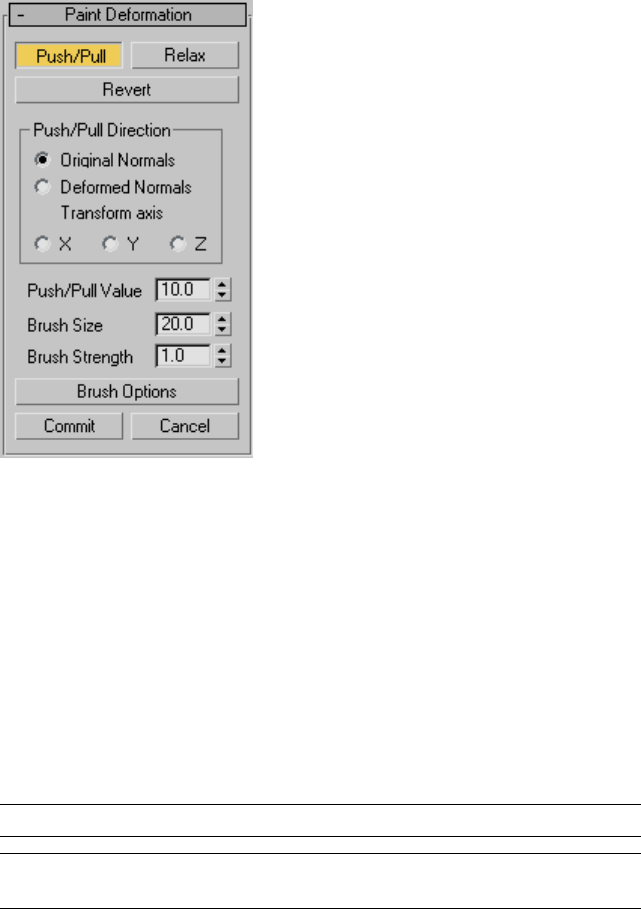
Interface
Paint Deformation has three modes of operation: Push/Pull, Relax, and Revert.
Only one of these modes can be active at a time. The remaining settings control
the effect of the active deformation mode.
For any mode, choose the mode, change settings as necessary, and then drag
the cursor over the object to paint the deformation.
To paint deformation anywhere on the object, remain at the object level, or
work at a sub-object level with no sub-objects selected. To deform only specific
areas of an object, go to a sub-object level and select the sub-objects in the
area to deform.
Push/Pull Moves vertices into the object surface (push) or out of the surface
(pull). The direction and extent of pushing or pulling is determined by the
Push/Pull Value setting.
TIP To reverse the Push/Pull direction while painting, press and hold Alt.
NOTE Push/Pull supports soft selection in that effective strength falls off with the
selection value of soft-selected sub-objects.
Paint Deformation Rollout | 2127

Relax Normalizes the distances between vertices by moving each vertex to
a position calculated from the average of its neighbors. Relax uses the same
method as the Relax modifier on page 1575 .
Use Relax to push apart vertices that are too close together, or to pull together
vertices that are too far apart.
Revert Lets you gradually “erase” or reverse the effects of Push/Pull or Relax
by painting. Affects only vertices deformed since the most recent Commit
operation. If no vertices qualify for reversion, the Revert button is unavailable.
TIP You can switch to Revert mode temporarily by pressing and holding the Ctrl
key while painting deformation in Push/Pull or Relax mode.
Push/Pull Direction group
This setting lets you specify whether pushing or pulling vertices occurs with
respect to surface normals, original or deformed, or along a specific axis.
Default=Original Normals.
Painting deformations with Original Normals typically moves vertices
perpendicular to the original surface; using Deformed Normals tends to move
vertices outward after their initial deformation, resulting in a “puffy” effect.
Original Normals When chosen, pushing or pulling a vertex moves it in the
direction of its normal before deformation. Repeated applications of Paint
Deformation always move each vertex in the same direction it moved
originally.
Deformed Normals When chosen, pushing or pulling a vertex moves it in
the current direction of the normal; that is, after deformation.
Transform axis X/Y/Z When chosen, pushing or pulling a vertex moves it
along the specified axis, using the current reference coordinate system on
page 896 .
Push/Pull Value Determines the direction and maximum extent of a single
application of the push/pull operation. Positive values “pull” vertices out of
the object surface, and negative values “push” vertices into the surface. Default
=10.0.
A single application is defined as painting (that is, dragging once or more over
the same area) without lifting the mouse button.
2128 | Chapter 10 Surface Modeling
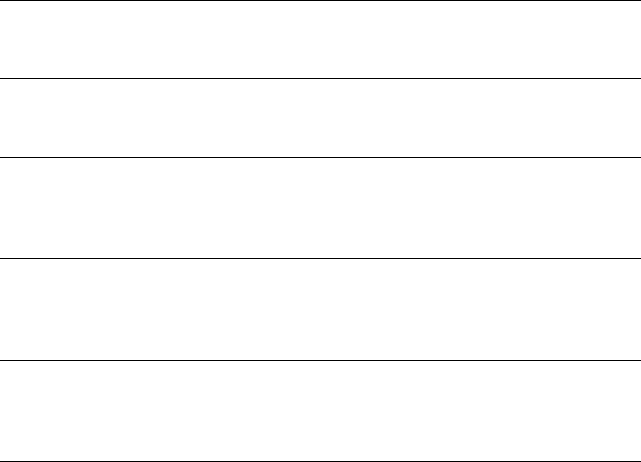
TIP You can use Alt to switch between pushing and pulling with the same value
while painting. For example, if you're pulling with a value of 8.5, press and hold
Alt to start pushing with a value of -8.5.
Brush Size Sets the radius of the circular brush. Only vertices inside the brush
circle are deformed. Default=20.0.
TIP To change the brush radius interactively, release the mouse button, press and
hold Shift+Ctrl+left mouse button, and then drag the mouse. This also works with
all other painter-interface features in 3ds Max such as Skin > Paint Weights and
VertexPaint.
Brush Strength Sets the rate at which the brush applies the Push/Pull value.
A low Strength value applies the effect more slowly than a high value.
Range=0.0 to 1.0. Default=1.0.
TIP To change the brush strength interactively, release the mouse button, press
and hold Shift+Alt+left mouse button, and then drag the mouse. This also works
with all other painter-interface features in 3ds Max such as Skin > Paint Weights
and VertexPaint.
Brush Options Click this button to open the Painter Options dialog on page
1907 , where you can set various brush-related parameters.
Commit Makes any deformation changes permanent, “baking” them into
the object geometry. After using Commit, you can no longer apply Revert to
changes up to that point.
Cancel Eliminates all changes since the initial application of Paint
Deformation or the most recent Commit operation.
Editable Poly Settings Dialogs
Bevel Polygons Dialog
Select an Edit Poly or editable poly object. > Modify panel > Polygon sub-object
level > Edit Polygons rollout > Bevel Settings button
Select an Edit Poly or editable poly object. > Polygon sub-object level > Quad
menu > tools 2 quadrant > Bevel Settings button
Editable Poly Settings Dialogs | 2129
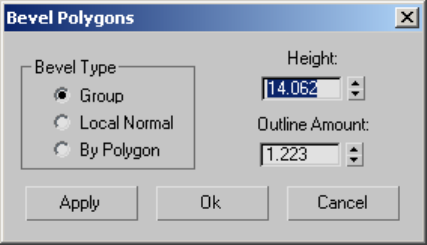
Beveling involves first extruding and then scaling the extruded polygon(s).
Use these settings for beveling polygons in Interactive Manipulation mode.
Interface
Bevel Type group
Group Beveling takes place along the average normal of each contiguous
group of polygons. If you bevel multiples of such groups, each group moves
along its own averaged normal.
Local Normal Beveling takes place along each selected polygon's normal.
By Polygon Bevels each polygon individually.
Height Specifies the extent of the extrusion in scene units. You can extrude
selected polygons outward or inward, depending on whether the value is
positive or negative.
Outline Amount Makes the outer border of selected polygons bigger or
smaller, depending on whether the value is positive or negative.
Apply Applies the settings to the current selection, retaining them if you
then make another selection.
OK Applies the settings to the current selection and closes the dialog.
Cancel Closes the dialog without applying the settings to the current
selection. Does not reverse previous uses of Apply.
2130 | Chapter 10 Surface Modeling
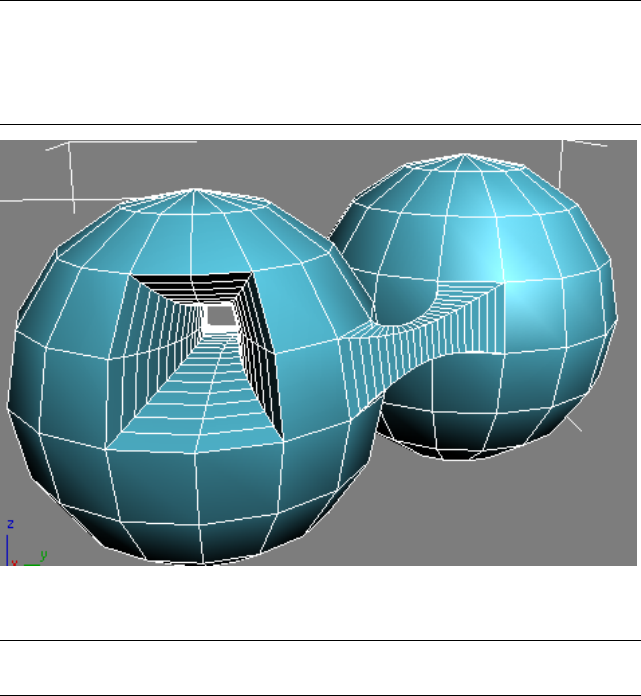
Bridge Borders/Polygons Dialog
Select an Edit Poly or editable poly object. > Modify panel > Polygon or Border
sub-object level > Edit Polygons rollout > Bridge Settings button
Select an Edit Poly or editable poly object. > Polygon or Border sub-object
level > Quad menu > tools 2 quadrant > Bridge Settings button
Use these settings for bridging pairs of polygons, polygon selections, or borders
in Interactive Manipulation mode.
NOTE Bridge calculates which way the bridge polygons should face. If you bridge
two sub-objects so that the bridge goes through the object, the bridge polygons
face inward. But if you create a bridge that goes through empty space, such as
when connecting sub-objects between two elements, the polygons face outward.
To make the bridge polygons face differently, use the Flip function.
Examples of an internal bridge (left) and an external bridge (right), the latter connecting
two elements
NOTE Bridging two elements makes them contiguous, combining them into a
single element.
Editable Poly Settings Dialogs | 2131
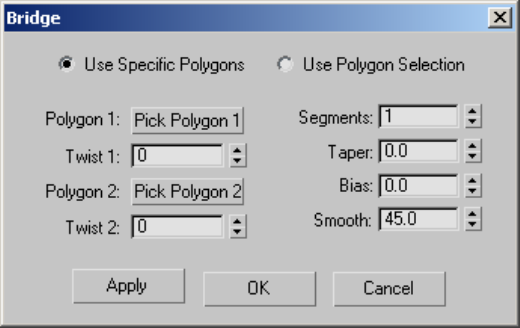
Interface
Bridge lets you use existing poly/border selections, or pick them from the
dialog. Choose one of the following:
Use Specific Polygons/Borders In this mode, use the Pick buttons to designate
polygons or borders for bridging.
Use Polygon/Border Selection If one or more qualifying selection pairs exist,
choosing this option connects them immediately. If not, you can select pairs
of sub-objects in a viewport to connect them.
If you make more than two qualifying selections, Bridge connects them in
increasing order of ID. For example, if you select polygon 12, 35, and 89,
Bridge connects polygons 12 and 35. But if you then deselect polygon 35,
Bridge then connects polygons 12 and 89.
Polygon/Edge 1/2 Click each Pick button in turn, and then click a polygon
or border edge in a viewport. At the Border sub-object level, clicking any edge
on a border designates the entire border for bridging. Also, the edges you pick
on each border are connected directly, and the remaining edges are connected
in consecutive order. You can change the order of the edge correspondences
with the Twist settings. Available only in Use Specific mode.
After clicking a sub-object, the Pick button shows its ID number. You can
change the selection at any time by clicking a Pick button and picking a
different sub-object.
Twist 1/2 Rotates the order of connection between the edges of the two
selections. The two controls let you set a different twist amount for each end
of the bridge.
2132 | Chapter 10 Surface Modeling
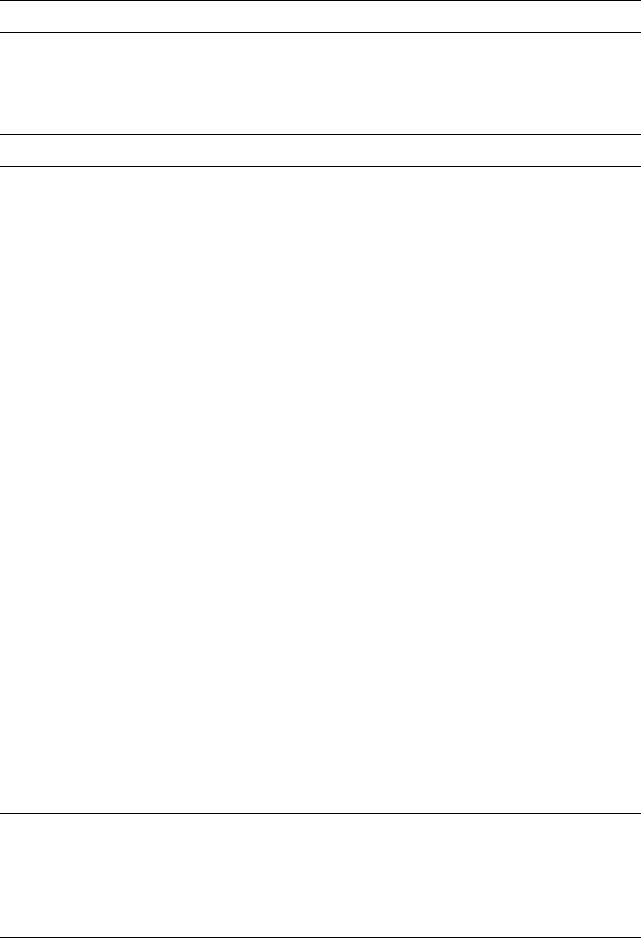
Segments Specifies the number of polygons along the length of the bridge
connection. This setting also applies to manually bridged polygons.
TIP When using Taper, set Segments to a value greater than 1.
Taper Sets the extent to which the bridge width becomes smaller or larger
toward its center. Negative settings taper the bridge center smaller; positive
settings taper it larger.
NOTE To change the location of maximum taper, use the Bias setting.
Bias Determines the location of maximum taper amount.
The range of the Bias value is -99.0 to 99.0. At the default value of 0.0, the
taper amount is greatest at the center of the bridge. At -99.0, the taper amount
is greatest near the first selected polygon or border; at 99.0, it's greatest near
the second selected polygon or border.
Smooth Determines the maximum angle between columns across which
smoothing can occur. A column is a string of polygons extending along the
length of the bridge.
Apply Applies the settings to the current selection, retaining them if you
then make another selection.
OK Applies the settings to the current selection and closes the dialog.
Cancel Closes the dialog without applying the settings to the current
selection. Does not reverse previous uses of Apply.
Bridge Edges Dialog
Select an Edit Poly or editable poly object. > Modify panel > Polygon or Border
sub-object level > Edit Polygons rollout > Bridge Settings button
Select an Edit Poly or editable poly object. > Polygon or Border sub-object
level > Quad menu > tools 2 quadrant > Bridge Settings button
Use these settings for bridging pairs of edges in Interactive Manipulation mode.
NOTE Bridge calculates which way the bridge polygons should face. If you bridge
two edges so that the bridge goes through the object, the bridge polygons face
inward. But if you create a bridge that goes through empty space, such as when
connecting edges between two elements, the polygons face outward, in general.
To make the bridge polygons face differently, use the Flip function.
Editable Poly Settings Dialogs | 2133
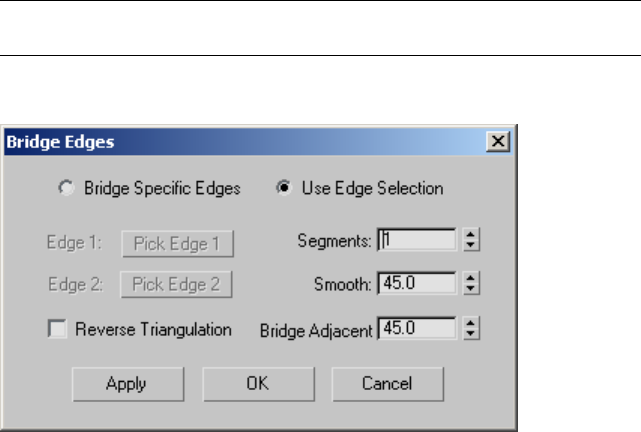
NOTE Bridging edges of two elements makes them contiguous, combining them
into a single element.
Interface
Bridge lets you use existing edge selections, or pick them from the dialog.
Choose one of the following:
Bridge Specific Edges In this mode, use the Pick buttons to designate
polygons or borders for bridging.
Use Edge Selection If one or more qualifying selection pairs exist, choosing
this option connects them immediately. If not, you can select pairs of
sub-objects in a viewport to connect them.
Edge 1/Edge 2 Click each Pick button in turn, and then click a border edge
in a viewport. Available only in Bridge Specific Edges mode.
After clicking an edge, the Pick button shows its ID number. You can change
the selection at any time by clicking a Pick button and picking a different
sub-object.
Segments Specifies the number of polygons along the length of the bridge
connection. This setting also applies to manually bridged edges.
Smooth Specifies the maximum angle between columns across which
smoothing can occur. A column is a string of polygons extending along the
length of the bridge.
Reverse Triangulation When bridging two edge selections each of which
contains different numbers of edges, two ways of triangulating the bridge
polygons are possible. This check box lets you toggle between them.
2134 | Chapter 10 Surface Modeling
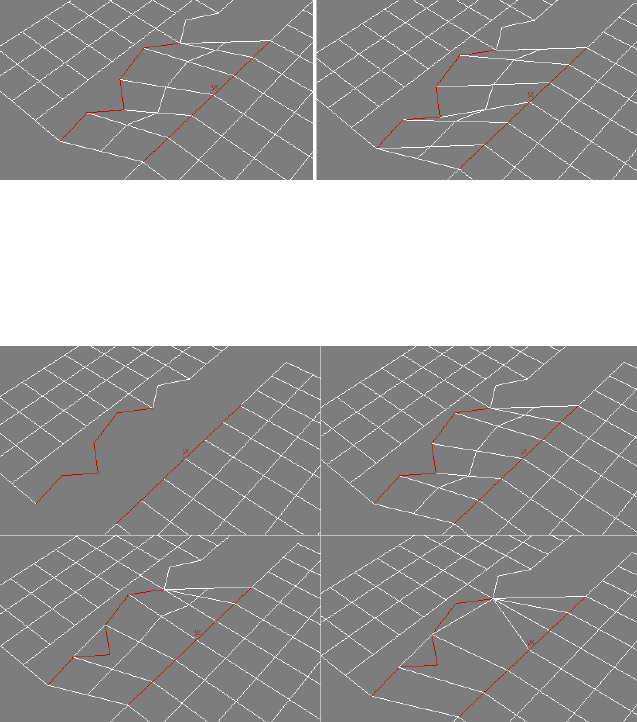
Left: Reverse Triangulation on
Right: Reverse Triangulation off
Bridge Adjacent Specifies the minimum angle between adjacent edges across
which bridging can occur. Edges less than this angle will not be bridged, and
instead will be skipped.
Top Left: Edge selections before bridging
Top Right: Segments=2, Bridge Adjacent<83.0
Bottom Left: Bridge Adjacent=83.0
Bottom Right: Bridge Adjacent=126.5
Editable Poly Settings Dialogs | 2135
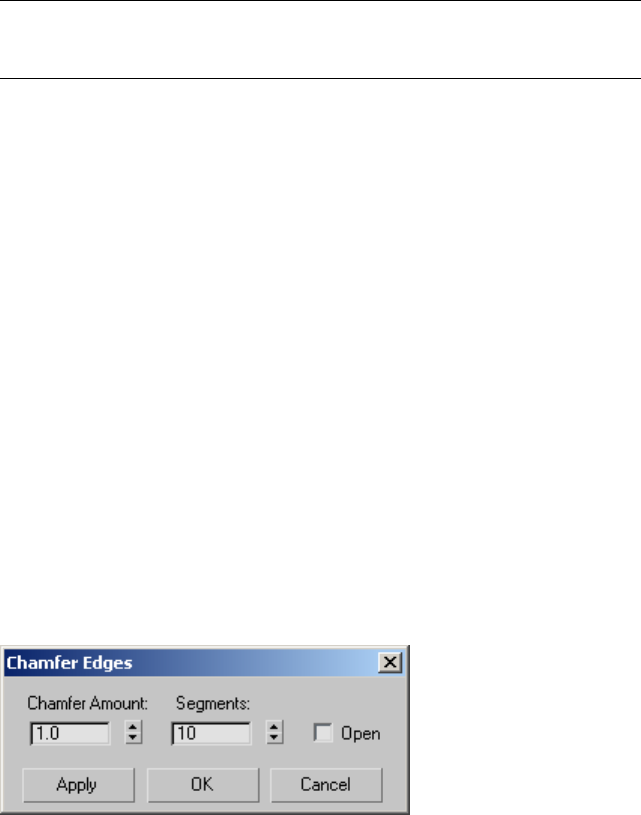
NOTE The above illustration shows, among other things, how setting Bridge
Adjacent too high can cause overlapping polygons (left side of the two bottom
images), which is undesirable.
Apply Applies the settings to the current selection, retaining them if you
then make another selection.
OK Applies the settings to the current selection and closes the dialog.
Cancel Closes the dialog without applying the settings to the current
selection. Does not reverse previous uses of Apply.
Chamfer Vertices/Edges/Borders Dialog
Select an Edit Poly or editable poly object. > Modify panel > Vertex/Edge/Border
sub-object level > Edit Vertices/Edges/Borders rollout > Chamfer Settings button
Select an Edit Poly or editable poly object. > Vertex/Edge/Border sub-object
level > Quad menu > tools 2 quadrant > Chamfer Settings button
Chamfering creates new faces around the chamfered entity, along with
connecting edges. Or, with the Open option, you can create an open (empty)
area instead. This dialog is the same for chamfering vertices, edges, and borders
of poly objects. You can use it to set the chamfer amount numerically, and
to toggle the Open option.
Interface
Chamfer Amount The extent of the chamfer. Default=1.0.
Segments (edges only) Adds edges and polygons over the area of the chamfer,
and, with single chamfered edges, rounds off the chamfer. By default, the
chamfer uses a single segment, which covers the chamfered area with a new
polygon positioned diagonally with respect to the original corner. The higher
the Segments value you use, the more the chamfer is rounded off.
2136 | Chapter 10 Surface Modeling

If you chamfer two or more adjacent, open edges at a time, the rounding off
takes place only at open ends of the edges. No rounding takes place where
the edges meet.
Open When on, the chamfered area is deleted, leaving open space.
Default=off.
This setting stays active during the current session. If you turn on Open and
then later chamfer sub-objects interactively, the Open option remains in effect.
Connect Edges Dialog
Select an Edit Poly or editable poly object. > Modify panel > Edge sub-object
level > Edit Edges rollout > Connect Settings button
Select an Edit Poly or editable poly object. > Edge sub-object level > Quad
menu > tools 2 quadrant > Connect Settings button
Connecting edges creates new edges between adjacent pairs of selected edges.
The Connect Edges dialog settings let you specify the number of new edges,
the amount of separation from each other, and their general location.
TIP Connecting edges, and in particular the Slide function, work best with ring
selections on page 2048 .
Editable Poly Settings Dialogs | 2137
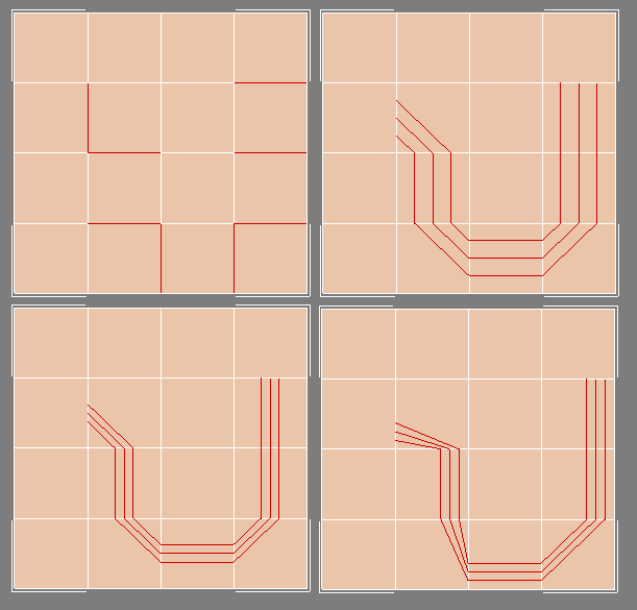
Top left: Original edge selection
Top right: Segments=3, Pinch=Slide=0
Bottom left: Segments=3, Pinch=-50, Slide=0
Bottom right: Segments=3, Pinch=-50, Slide=–200
2138 | Chapter 10 Surface Modeling
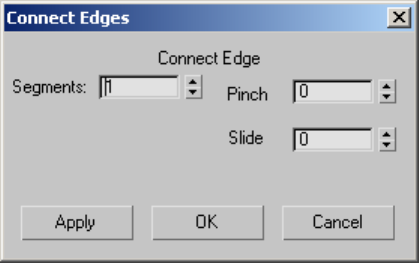
Interface
Segments The number of new edges between each adjacent pair of selected
edges. Default=1.
Pinch The relative spacing between the new, connecting edges. Negative
values move the edges closer together; positive values move them farther
apart. Default=0.
If Segments=1, the Pinch setting has no effect.
Slide The relative positioning of the new edges. Default=0.
By default, the new edges are centered. Positive values move them in one
direction, while negative values move them in the opposite direction. The
new edges cannot move beyond existing edges.
Extrude Polygons Along Spline Dialog
Select an Edit Poly or editable poly object. > Modify panel > Polygon sub-object
level > Edit Polygons rollout > Extrude Along Spline Settings button
Select an Edit Poly or editable poly object. > Polygon sub-object level > Quad
menu > tools 2 quadrant > Extrude Along Spline Settings button
Use these settings for extruding polygons along splines in Interactive
Manipulation mode.
Editable Poly Settings Dialogs | 2139
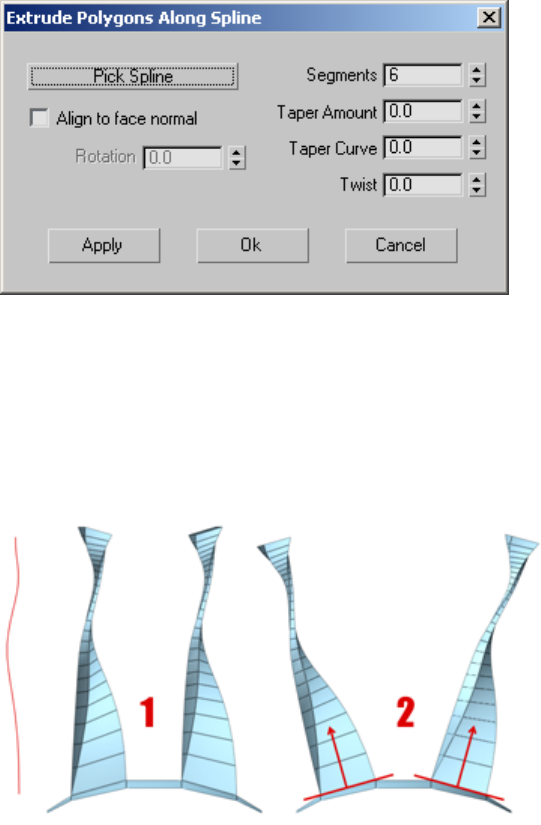
Interface
Pick Spline Click this button and then select a spline along which to extrude
in the viewport. The spline object's name then appears on the button.
If you open this dialog after performing a manual Extrude Along Spline, the
name of the spline you used appears on the button.
Align to face normal Aligns the extrusion with the face normal, which, in
most cases, makes it perpendicular to the extruded polygon(s). When turned
off (the default), the extrusion is oriented the same as the spline.
With Align To Face Normal, the extrusion does not follow the original orientation of
the spline (1); it’s reoriented to match the face normals (2), or averaged normals for
contiguous selections. The Rotation option is available only when Align To Face Normal
is on.
2140 | Chapter 10 Surface Modeling
Rotation Sets the rotation of the extrusion. Available only when Align To
Face Normal is on. Default=0. Range=-360 to 360.
Segments Specifies the number of polygons into which each extruded side
is subdivided. This setting also applies to manually extruded polygons.
Taper Amount Sets the extent to which the extrusion becomes smaller or
larger along its length. Negative settings taper the extrusion smaller; positive
settings taper it larger.
Taper Curve Sets the rate at which the tapering proceeds. Lower settings
result in a more gradual taper; large settings result in a more abrupt taper.
Taper Curve affects the thickness of the extrusion between its endpoints, but
not the size of the ends.
Twist Applies a twist along the length of the extrusion.
When using this option, increasing the number of segments will improve the
smoothness of the extrusion.
Apply Applies the settings to the current selection, retaining them if you
then make another selection.
OK Applies the settings to the current selection and closes the dialog.
Cancel Closes the dialog without applying the settings to the current
selection. Does not reverse previous uses of Apply.
Extrude Polygons Dialog
Select an Edit Poly or editable poly object. > Modify panel > Polygon sub-object
level > Edit Polygons rollout > Extrude Settings button
Select an Edit Poly or editable poly object. > Polygon sub-object level > Quad
menu > tools 2 quadrant > Extrude Settings button
Use these settings for extruding polygons in Interactive Manipulation mode.
Editable Poly Settings Dialogs | 2141
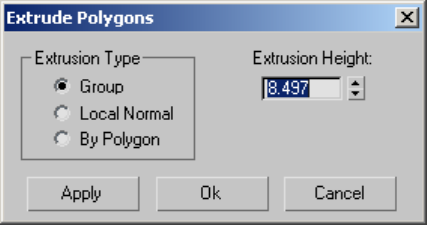
Interface
Extrusion Type group
Group Extrusion takes place along the average normal of each contiguous
group of polygons. If you extrude multiples of such groups, each group moves
along its own averaged normal.
Local Normal Extrusion takes place along each selected polygon's normal.
By Polygon Extrudes or bevels each polygon individually.
Extrusion Height Specifies the amount of the extrusion in scene units. You
can extrude selected polygons outward or inward, depending on whether the
value is positive or negative.
Apply Applies the settings to the current selection, retaining them if you
then make another selection.
OK Applies the settings to the current selection and closes the dialog.
Cancel Closes the dialog without applying the settings to the current
selection. Does not reverse previous uses of Apply.
Extrude Vertices/Edges Dialog
Select an Edit Poly or editable poly object. > Modify panel > Vertex/Edge/Border
sub-object level > Edit Vertices/Edges/Borders rollout > Extrude Settings button
Select an Edit Poly or editable poly object. > Vertex/Edge/Border sub-object
level > Quad menu > tools 2 quadrant > Extrude Settings button
Use this dialog for extruding vertices, edges, and borders in Interactive
Manipulation mode.
2142 | Chapter 10 Surface Modeling
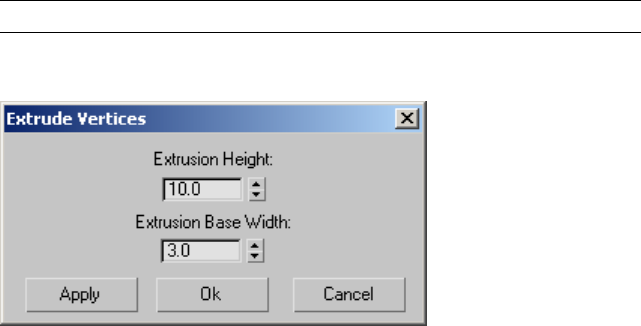
NOTE At the Border sub-object level, this dialog is named Extrude Edges.
Interface
Extrusion Height Specifies the amount of the extrusion in scene units.
You can extrude sub-objects outward or inward, depending on whether the
value is positive or negative.
Extrusion Base Width Specifies the size of the extrusion base in scene units.
You can set this as high as you want, but the actual size cannot extend beyond
the vertices adjacent to the extruded sub-object(s).
Apply Applies the settings to the current selection, retaining them if you
then make another selection.
OK Applies the settings to the current selection and closes the dialog.
Cancel Closes the dialog without applying the settings to the current
selection. Does not reverse previous uses of Apply.
Hinge Polygons From Edge Dialog
Select an Edit Poly or editable poly object. > Modify panel > Polygon sub-object
level > Edit Polygons rollout > Hinge From Edge Settings button
Select an Edit Poly or editable poly object. > Polygon sub-object level > Quad
menu > tools 2 quadrant > Hinge From Edge Settings button
Use these settings for hinging polygons in Interactive Manipulation mode.
Editable Poly Settings Dialogs | 2143
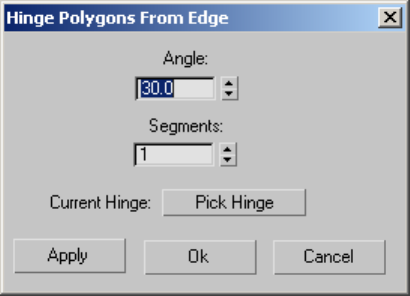
Interface
Angle Quantifies the rotation about the hinge. You can hinge selected
polygons outward or inward, depending on whether the value is positive or
negative.
Segments Specifies the number of polygons into which each extruded side
is subdivided. This setting also applies to manually hinged polygons.
Current Hinge Click Pick Hinge, and then click an edge to be the hinge.
After you designate a hinge, the “Pick Hinge” button text is replaced with
“Edge #” where # is the ID number of the hinge edge.
All subsequent hinge operations created via the dialog will use this hinge. To
hinge multiple polygons, each from one of its own sides, you must reselect
the hinge each time.
Apply Applies the settings to the current selection, retaining them if you
then make another selection.
OK Applies the settings to the current selection and closes the dialog.
Cancel Closes the dialog without applying the settings to the current
selection. Does not reverse previous uses of Apply.
Inset Polygons Dialog
Select an Edit Poly or editable poly object. > Modify panel > Polygon sub-object
level > Edit Polygons rollout > Inset Settings button
2144 | Chapter 10 Surface Modeling
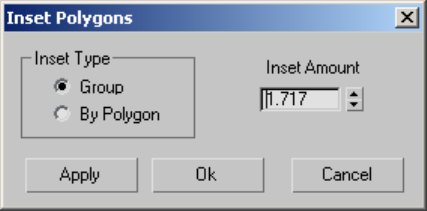
Select an Edit Poly or editable poly object. > Polygon sub-object level > Quad
menu > tools 2 quadrant > Inset Settings button
Use these settings for insetting polygons in Interactive Manipulation mode.
Interface
Inset Type group
This setting affects how Inset works with selections of more than one polygon.
Group The inset takes place across multiple, contiguous polygons.
By Polygon Insets each polygon individually.
Inset Amount Specifies the amount of the inset in scene units.
Apply Applies the settings to the current selection, retaining them if you
then make another selection.
OK Applies the settings to the current selection and closes the dialog.
Cancel Closes the dialog without applying the settings to the current
selection. Does not reverse previous uses of Apply.
MeshSmooth Selection Dialog
Select an Edit Poly or editable poly object. > Modify panel > Polygon sub-object
level > Edit Geometry rollout > MSmooth Settings button
This dialog lets you specify how mesh smoothing affects editable poly and
Edit Poly objects.
Editable Poly Settings Dialogs | 2145
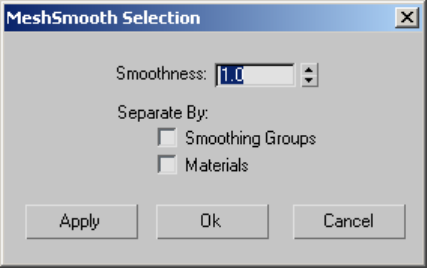
Interface
Smoothness Determines how sharp a corner must be before polygons are
added to smooth it. Smoothness is calculated as the average angle of all edges
connected to a vertex. A value of 0.0 prevents the creation of any polygons.
A value of 1.0 adds polygons to all vertices even if they lie on a plane.
Separate by Smoothing Groups Prevents the creation of new polygons at
edges between polygons that don't share at least one smoothing group.
Separate by Materials Prevents the creation of new polygons for edges
between polygons that do not share Material IDs.
Apply Applies the settings to the current selection, retaining them if you
then make another selection.
OK Applies the settings to the current selection and closes the dialog.
Cancel Closes the dialog without applying the settings to the current
selection. Does not reverse previous uses of Apply.
Preserve Map Channels Dialog
Select an Edit Poly or editable poly object. > Modify panel > any sub-object
level > Edit Geometry rollout > Preserve UVs button
Use these settings for specifying which map channels to preserve when editing
sub-objects with the Preserve UVs option on. A preserved map channel doesn't
respond to minor editing that changes vertex locations, but a channel whose
UVs aren't preserved allows mapping to be changed by changes in vertex
locations.
2146 | Chapter 10 Surface Modeling
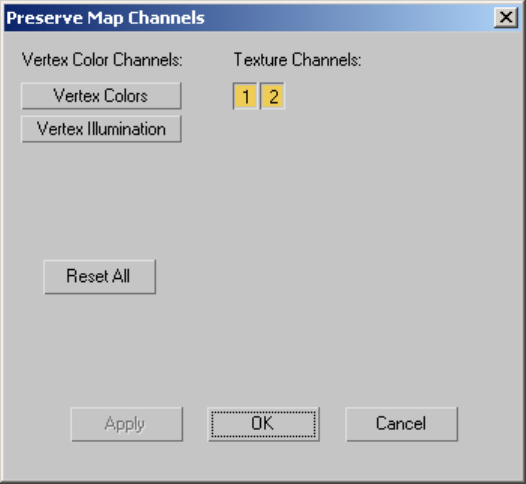
Interface
The dialog contains buttons for all available, data-containing vertex color
channels and texture channels. The number and type of buttons displayed
vary depending on the state of the object; they can be changed, for example,
with the VertexPaint modifier on page 1876 and the Channel Info utility on
page 5858 .
Click a button to toggle its state. When off, a button is gray and appears higher
than the dialog surface. When on, a button is orange and appears pressed in.
Vertex Color Channels Displays buttons for any vertex-color channels that
contain data. These can be Vertex Colors, Vertex Illumination, and Vertex
Alpha. By default, all vertex-color buttons are off, so that associated UVs are
affected by sub-object editing. To prevent a channel from being affected by
sub-object editing, click its button.
Texture Channels Displays buttons for any texture (mapping) channels that
contain data. These are identified by number. By default these are on, so that
associated UVs are not affected by sub-object editing. To allow a channel to
be affected by sub-object editing, click its button.
Editable Poly Settings Dialogs | 2147
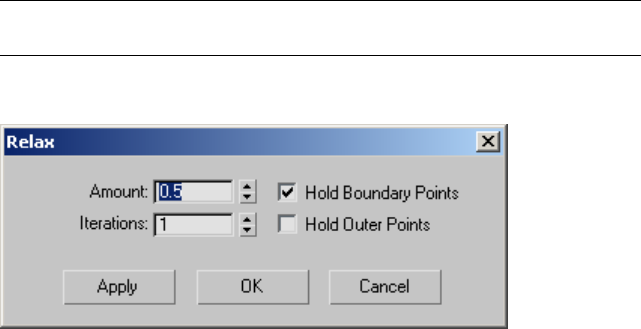
Reset All Returns all channel buttons to their default states: all vertex color
channels off, all texture channels on.
Apply Applies the settings to the current selection, retaining them if you
then make another selection.
OK Applies the settings to the current selection and closes the dialog.
Cancel Closes the dialog without applying the settings to the current
selection. Does not reverse previous uses of Apply.
Relax Dialog
Select an Edit Poly or editable poly object. > Modify panel > object level or
any sub-object level > Edit Polygons rollout > Relax Settings button
Select an Edit Poly or editable poly object. > object level or any sub-object
level > Quad menu > tools 2 quadrant > Relax Settings button
Use these settings for relaxing vertices in Interactive Manipulation mode.
Relax in Edit/Editable Poly works much like the Relax modifier on page 1575 :
It normalizes the distance between each affected vertex and its neighbors by
moving the vertex toward the average position of its neighbors.
NOTE At the object level, Relax applies to the entire object. At any sub-object
level, Relax applies to selected sub-objects only.
Interface
Amount Controls how far a vertex moves for each iteration. The value
specifies a percentage of the distance from the original location of a vertex to
the average location of its neighbors. Range=-1.0 to 1.0. Default=0.5.
2148 | Chapter 10 Surface Modeling
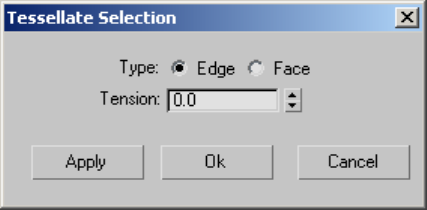
Iterations Sets how many times to repeat the Relax process. For each iteration,
average locations are recalculated and the Relax Value is reapplied to every
vertex. Default=1.
Hold Boundary Points Controls whether vertices at the edges of open meshes
are moved. Default=on.
When on, boundary vertices do not move while the rest of the object is relaxed.
This option is particularly useful when working with multiple elements within
a single object that share open edges.
When this check box is off, all vertices of the object are relaxed.
Hold Outer Points When on, preserves the original positions of vertices
farthest away from the object center.
Apply Applies the settings to the current selection, retaining them if you
then make another selection.
OK Applies the settings to the current selection and closes the dialog.
Cancel Closes the dialog without applying the settings to the current
selection. Cancel does not reverse previous uses of Apply.
Tessellate Selection Dialog
Select an Edit Poly or editable poly object. > Modify panel > Polygon sub-object
level > Edit Polygons rollout > Tessellate Settings button
This dialog lets you specify how Tessellate should subdivide polygons.
Interface
Editable Poly Settings Dialogs | 2149
Edge Inserts vertices in the middle of each edge and draws lines connecting
those vertices. The number of polygons created will equal the number of sides
of the original polygon.
Face Adds a vertex to the center of each polygon and draws connecting lines
from that vertex to the original vertices. The number of polygons created will
equal the number of sides of the original polygon.
Tension Lets you increase or decrease the Edge tension value. Available only
when Type: Edge is active.
A negative value pulls vertices inward from their plane, resulting in a concave
effect. A positive value pulls vertices outward from their plane, resulting in a
rounding effect.
Apply Applies the settings to the current selection, retaining them if you
then make another selection.
OK Applies the settings to the current selection and closes the dialog.
Cancel Closes the dialog without applying the settings to the current
selection. Does not reverse previous uses of Apply.
Weld Vertices/Edges Dialog
Select an Edit Poly or editable poly object. > Modify panel > Vertex or Edge
sub-object level > Edit Vertices/Edges rollout > Weld Settings button
Select an Edit Poly or editable poly object. > Vertex or Edge sub-object level
> Quad menu > tools 2 quadrant > Weld Settings button
Use this dialog for setting the weld threshold for vertices and edges.
2150 | Chapter 10 Surface Modeling
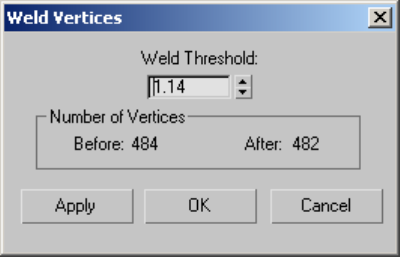
Interface
Weld Threshold Specifies the maximum distance, in scene units, within
which selected sub-objects will be welded.
Any vertex or edge that lies outside this threshold (that is, it's farther than
this from the nearest vertex or edge) will not be welded.
Number of Vertices Shows the number of vertices before and after the weld.
The After quantity updates dynamically as you change the setting with the
spinner.
Apply Applies the settings to the current selection, retaining them if you
then make another selection.
OK Applies the settings to the current selection and closes the dialog.
Cancel Closes the dialog without applying the settings to the current
selection. Does not reverse previous uses of Apply.
Editable Poly Settings Dialogs | 2151
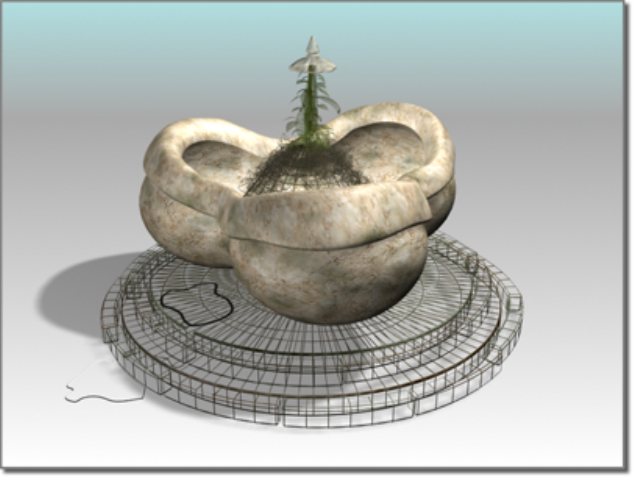
NURBS Modeling
Fountain created as a NURBS model
3ds Max provides NURBS surfaces and curves. NURBS stands for Non-Uniform
Rational B-Splines. NURBS have become an industry standard for designing and
modeling surfaces. They are especially suited for modeling surfaces with
complicated curves. The tools for modeling with NURBS do not require an
understanding of the mathematics that produces these objects. NURBS are
popular because they are easy to manipulate interactively, and because the
algorithms that create them are both efficient and numerically stable.
You can also model surfaces using polygonal meshes or patches. Compared
to NURBS surfaces, meshes and patches have these shortcomings:
■Using polygons can make it more difficult to create complicated curved
surfaces.
■Because meshes are faceted, facets appear at the edge of rendered objects.
You must have a large number of small faces to render a smoothly curved
edge.
2152 | Chapter 10 Surface Modeling
NURBS surfaces, on the other hand, are analytically generated. They are more
efficient to calculate, and you can render a NURBS surface that appears to be
seamless. (A rendered NURBS surface is actually approximated by polygons,
but the NURBS approximation can be very fine grained.)
NURBS Models: Objects and Sub-Objects on page 2153
NURBS and Modifiers on page 2172
NURBS and Animation on page 2175
NURBS Concepts on page 2176
NURBS Models: Objects and Sub-Objects
Like Shape on page 536 objects, a NURBS model can be an assemblage of
multiple NURBS sub-objects. For example, a NURBS object might contain two
surfaces that are separate in space. NURBS curves and NURBS surfaces are
controlled by either point or control vertex (CV) sub-objects. Points and CVs
behave somewhat like the vertices of spline objects, but there are differences.
The parent object in a NURBS model is either a NURBS surface or a NURBS
curve. Sub-objects can be any of the objects listed here. A NURBS curve remains
a Shape object unless you add a surface sub-object to it when you convert it
to a NURBS surface (without changing its name).
Surfaces There are two kinds of NURBS surfaces. A point surface on page
2192 is controlled by points, which always lie on the surface. A CV surface on
page 2195 is controlled by control vertices (CVs). Instead of lying on the surface,
CVs form a control lattice on page 7745 that surrounds the surface. (This is
similar to the lattice used by the FFD [free-form deformation] modifiers.)
See Creating Surface Sub-Objects on page 2337 and Editing Surface Sub-Objects
on page 2264 .
Curves There are also two kinds of NURBS curves. These correspond exactly
to the two kinds of surfaces. A point curve on page 2201 is controlled by points,
which always lie on the curve. A CV curve on page 2208 is controlled by CVs,
which don't necessarily lie on the curve.
See Creating Surface Sub-Objects on page 2337 and Editing Curve Sub-Objects
on page 2252 .
Points Point surfaces and point curves have point on page 2429 sub-objects.
You can also create separate point sub-objects that are not part of a surface or
a curve.
NURBS Models: Objects and Sub-Objects | 2153
See Creating and Editing Point Sub-Objects on page 2428 .
CVs CV surfaces and CV curves have CV sub-objects. Unlike points, CVs are
always part of a surface or a curve.
See Editing Curve CV Sub-Objects on page 2238 and Editing Surface CV
Sub-Objects on page 2244 .
Imports Imports are 3ds Max objects, including other NURBS objects. Within
the NURBS model, they render as NURBS; but they retain their original
parameters and modifiers.
See Attaching and Importing 3ds Max Objects on page 2225 .
Sub-objects can be dependent on page 2169 sub-objects whose geometry is
related to the geometry of other sub-objects.
See also:
■Creating NURBS Models on page 2154
■Working with NURBS Models on page 2155
■Modifying NURBS Models and Creating Sub-Objects on page 2159
■Sub-Object Selection on page 2164
■CV Sub-Objects and Point Sub-Objects on page 2165
■Rigid Surfaces on page 2172
■Dependent Sub-Objects on page 2169
■Nonrelational NURBS Surfaces on page 2219
Creating NURBS Models
There are a variety of ways to create NURBS models. This is a summary of how
you create a top-level, parent NURBS object:
■You can create a NURBS curve on page 2199 on the Shape on page 536
panel of the Create panel.
■You can create a NURBS surface on page 2190 on the Geometry on page
317 panel of the Create panel. When you use this technique, the NURBS
surface is initially a flat rectangle. You can alter it using the Modify panel.
2154 | Chapter 10 Surface Modeling
■You can turn a standard geometry primitive on page 348 into a NURBS
object.
■You can turn a torus knot on page 389 into a NURBS object.
■You can turn a prism on page 423 extended primitive into a NURBS object.
■You can turn a spline on page 542 object (Bezier spline) into a NURBS
object.
■You can turn a patch grid on page 1982 object (Bezier patch) into a NURBS
object.
■You can turn a loft on page 715 object into a NURBS object.
To turn objects other than NURBS curves and surfaces into NURBS objects,
use the Modify panel. Right-click the object's name in the stack display (see
Modifier Stack on page 7427 ) and choose Convert To: NURBS.
In viewports, the quad menu on page 7300 also lets you convert objects to
NURBS. Select and then right-click the object, and in the Transform
(lower-right) quadrant, choose Convert To: > Convert to NURBS.
■In addition, the modifiers Extrude on page 1377 and Lathe on page 1430 let
you choose NURBS output, which creates a NURBS object.
Working with NURBS Models
When you work with NURBS models, usually you follow these overall steps:
■Create one NURBS object as the "starter" object. This can be a surface object,
a curve object, or a converted geometry primitive, as described in Creating
NURBS Models on page 2154 .
Often modelers like to identify a single, master surface as the main
component of the model. Converted geometry primitives are good if you
want the starter surface to become the master surface. See Creating NURBS
Surfaces from Geometric Primitives on page 2218 . Point and CV surfaces are
good as starters for rectangular surfaces.
■On the Modify panel, you can edit the original object, or you can create
additional sub-objects.
See Using the NURBS Toolbox to Create Sub-Objects on page 2162 .
You might even choose to delete the original, starter object once you have
built a model from newer sub-objects.
NURBS Models: Objects and Sub-Objects | 2155
Going immediately to the Modify panel avoids the problem of creating
additional top-level NURBS objects, which you can't use to build relational,
dependent sub-objects. (The exception is using curves for loft and sweep
surfaces. See U Loft Surface on page 2380 , UV Loft Surface on page 2390 , 1-Rail
Sweep Surface on page 2397 , or 2-Rail Sweep Surface on page 2407 .)
Two general references for modeling with NURBS are Curves and Surfaces for
Computer-Aided Geometric Design: A Practical Guide by Gerald Farin (Academic
Press, fourth edition 1996) and Interactive Curves and Surfaces: A Multimedia
Tutorial on Computer Aided Graphic Design by Alyn Rockwood and Peter Chambers
(Morgan Kaufman Publishers, 1996).
Surface Trimming
To trim a surface is to use a curve on the surface to cut away part of the surface,
or to cut a hole in the surface.
Before you trim a surface, you must create a curve on that surface. These are
the kinds of curves that can trim surfaces:
■U iso and V iso curves on page 2318
■Surface-surface intersection curve on page 2312
■Normal projected curve on page 2320
■Vector projected curve on page 2323
■CV curve on surface on page 2327
■Point curve on surface on page 2331
Once you've created the curve, you trim the surface by turning on Trim in
the curve sub-object's parameters. A Flip Trim control inverts the trim direction.
The direction of the curve determines the initial direction of the trim. For
example, a closed curve on surface created in a clockwise direction trims
inward, creating a hole in the surface; while a closed curve on surface created
in a counterclockwise direction trims outward, creating a curve-shaped portion
of the surface.
When a surface is trimmed, its untrimmed version is still present in the 3ds
Max scene. You can select it for the purposes of editing it, or replacing it as a
parent to a dependent sub-object on page 2169 . For details, see Sub-Object
Selection on page 2164 .
2156 | Chapter 10 Surface Modeling
Procedures
Example: To cut a hole in a CV surface:
1Create a CV surface in the Top viewport.
2Create a closed CV curve sub-object that lies on top of (or above) the
surface.
3In the toolbox, turn on Normal Projected Curve, then in the Top viewport
select first the CV curve, then the surface.
This creates a projection of the CV curve that lies on the surface, and can
trim it.
4In the normal projected curve's parameters, click to turn on Trim.
A hole appears in the surface. Depending on the orientation of the Normal
Projected curve, you might see everything but the hole.
5Use the Flip Trim toggle to invert the trim.
NURBS Models: Objects and Sub-Objects | 2157
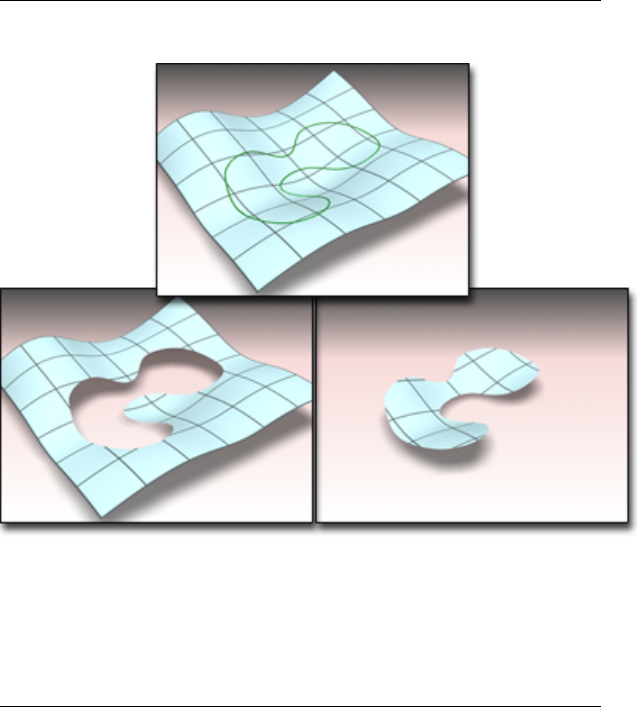
NOTE Trims aren't displayed in viewports if the NURBS surface's Surface
Trims toggle is turned off on the General rollout's Display group box.
Above: CV curve on surface
Below left: Using the curve to trim the surface
Below right: Using Flip Trim to change the trimming direction
To select an untrimmed surface:
1Make sure the Keyboard Shortcut Override toggle on page 7646 is on.
2At the appropriate sub-object level or during a replace parent operation,
press H. This opens the Select Sub-Objects dialog, which is a subset of the
Selection Floater on page 171 that you can use during sub-object creation
as well as sub-object selection.
3If the untrimmed version is selectable at this level, the trimmed version
appears as a "tree," with a plus sign next to it. Click the plus sign to expand
2158 | Chapter 10 Surface Modeling
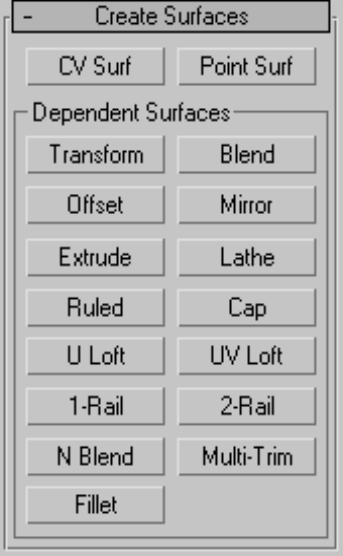
the tree. The child is the untrimmed version. Highlight its name to select
it.
Modifying NURBS Models and Creating
Sub-Objects
You can edit NURBS immediately when you enter the Modify panel. You don’t
have to apply a modifier, as you do for most kinds of 3ds Max objects.
While you are editing a NURBS object on the Modify panel, you can create
sub-objects "on the fly," without having to go back to the Create panel. This
is an exception to the way you usually use 3ds Max. The Modify panel for
NURBS curve and NURBS surface objects includes rollouts that let you create
new NURBS sub-objects.
Example: Rollout for creating NURBS surface sub-objects
NURBS Models: Objects and Sub-Objects | 2159
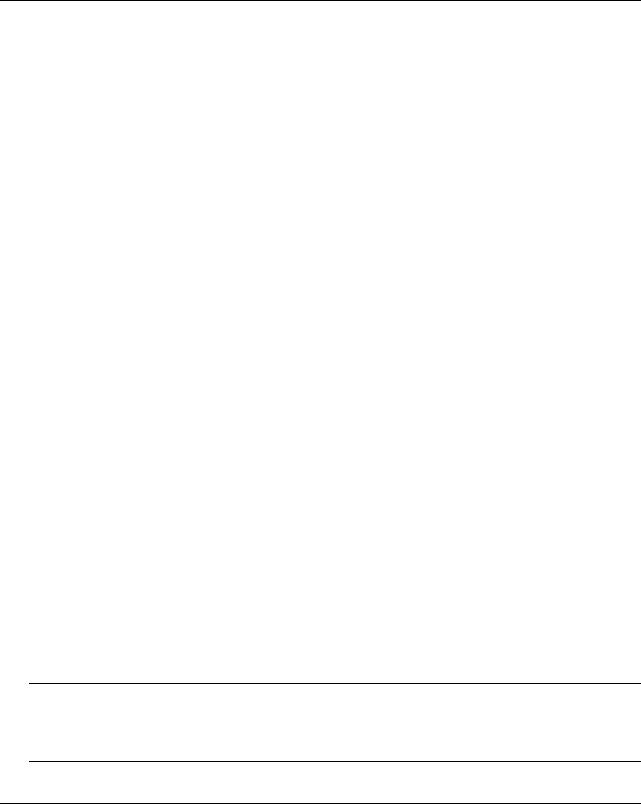
TIP Another way to create curve and surface sub-objects is to use the NURBS
Creation Toolbox on page 2162 .
This is a summary of how to create sub-objects:
■An individual point sub-object is either an independent point or a
dependent point tied to other NURBS geometry.
■Curve sub-objects are either independent point curves or CV curves, or
they are dependent on page 7756 curves whose geometry is based on other
curves or surfaces already present in the model. For example, a blend curve
is a dependent curve sub-object that connects the endpoints of two other
curves.
■Surface sub-objects are either independent point surfaces or CV surfaces,
or they are dependent on page 7756 surfaces whose geometry is based on
other surfaces or curves already present in the model. For example, a blend
surface is a dependent surface sub-object that connects the edges of two
other surfaces.
■You can attach 3ds Max objects. If the attached object is not already a
NURBS object, it is converted to NURBS geometry. You can attach a NURBS
curve, another NURBS surface, or a convertible 3ds Max object. The
attached object becomes one or more curve or surface sub-objects.
■You can import 3ds Max objects. The imported object retains its parameters.
While it is part of the NURBS object it renders as a NURBS, but you can
still edit it parametrically at the Imports sub-object level. At this sub-object
level, viewports display its usual geometry, not its NURBS form. A NURBS
curve can import NURBS curves or spline curves. A NURBS surface can
import curves, surfaces, or convertible 3ds Max objects.
NOTE You can detach a NURBS sub-object to make it a new, top-level NURBS
object, and you can extract an imported object to create an independent,
top-level object once again.
Quad Menu for NURBS Objects
While a NURBS object is selected and the Modify panel is active, the quad
menu on page 7300 displays two quadrants that are specifically for NURBS
editing.
2160 | Chapter 10 Surface Modeling
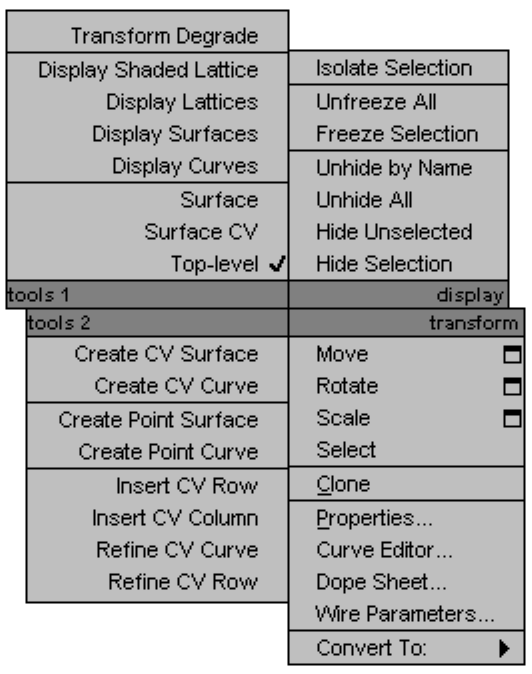
Quad menu for modifying NURBS models
Tools 1 (upper-left) Quadrant
These options are general display and sub-object level shortcuts.
Transform Degrade Toggles Degradation Override on page 83 .
Display Shaded Lattice, Display Lattices, Display Surfaces, and Display
Curves See Display Controls for NURBS Models on page 2221 .
Sub-objects Displays the sub-object choices for the selected object, as well
as a Top-level choice.
NURBS Models: Objects and Sub-Objects | 2161

Tools 2 (lower-left) Quadrant
These options are creation and editing shortcuts.
Create CV Surface, Create CV Curve, Create Point Surface, Create Point
Curve These create a new NURBS sub-object.
Insert CV Row, Insert CV Column, Refine CV Curve, Refine CV Row These
add CVs to a CV Surface sub-object by inserting or refining. For the difference
between inserting and refining, see Editing Surface CV Sub-Objects on page
2244 . See NURBS Concepts on page 2176 for more information about refining.
Using the NURBS Toolbox to Create Sub-Objects
Modify panel > Select NURBS object. > General rollout > NURBS Creation
Toolbox button
Keyboard > Ctrl+T (Keyboard Shortcut Override Toggle must be on.)
Besides using rollouts at the NURBS object level, you can use the NURBS
toolbox to create sub-objects.
2162 | Chapter 10 Surface Modeling
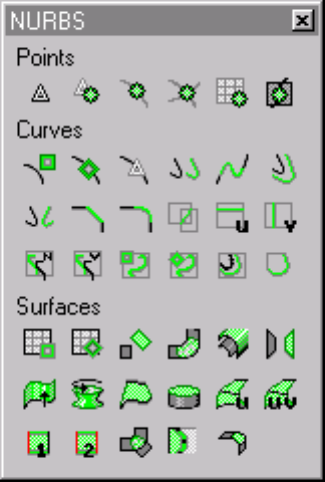
Interface
Toolbox for NURBS objects
The toolbox contains buttons for creating NURBS sub-objects. In general, the
toolbox behaves like this:
■While the button is on, the toolbox is visible whenever a NURBS object
or sub-object is selected and you are on the Modify panel. It disappears
whenever you deselect the NURBS object or make a different panel active.
When you return to the Modify panel and select a NURBS object, it
reappears.
■You can use the toolbox to create sub-objects from either the top, object
level, or from any NURBS sub-object level.
■When you turn on a toolbox button, you go into creation mode, and the
Modify panel changes to show the parameters (if there are any) for the
kind of sub-object you are creating.
Other NURBS rollouts aren't displayed while you create the new sub-object.
This differs from using the NURBS object's Create rollouts or the NURBS
right-click menu on page 2160 .
NURBS Models: Objects and Sub-Objects | 2163
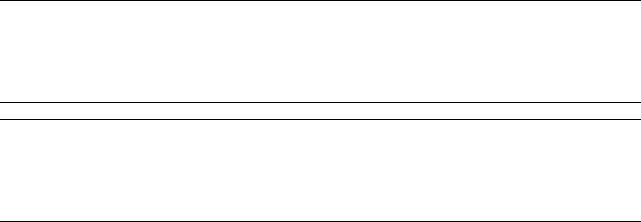
■If you are at the top, object level and use the toolbox to create a sub-object,
you must then go to the sub-object level to edit the new sub-object. (This
is the same as using the buttons on the rollouts.)
■If you are at a sub-object level and use the toolbox to create an object of
the same sub-object type, you can edit it immediately after you turn off
the create button (or right-click to end object creation).
■If you are at a sub-object level and use the toolbox to create an object of
a different sub-object type, you must change to that sub-object level before
you can edit the new sub-object.
The individual creation buttons are described in these topics:
Creating and Editing Point Sub-Objects on page 2428
Creating Curve Sub-Objects on page 2283
Creating Surface Sub-Objects on page 2337
Sub-Object Selection
When you work with NURBS models, you often work with sub-objects. While
you are at the sub-object level, you use the usual selection techniques, such
as clicking, dragging a region, or holding down Ctrl, to choose one or more
sub-objects.
You can also select NURBS point, curve, and surface sub-objects by name.
Turn on the Keyboard Shortcut Override Toggle on page 7646 , go to a NURBS
sub-object level, and then press the H key. This opens the Select Sub-Objects
dialog, which is a subset of the Selection Floater on page 171 that lists only
sub-objects at the current level. Choose one or more objects in the list, and
then click Select. You can assign your own names to NURBS sub-objects (aside
from CVs) that you want to edit frequently.
TIP
Press Ctrl+H to have the Select Sub-Objects dialog list only sub-objects directly
beneath the mouse cursor.
TIP
The H shortcut is also a convenient way to choose parent objects while you're
creating dependent sub-objects.
2164 | Chapter 10 Surface Modeling
Workflow Tips
When you work with NURBS, you switch frequently between the object and
sub-object levels, or from one sub-object level to another. Keyboard shortcuts
and pop-up menus can help you do this.
■The Sub-Object Selection Toggle (default: Ctrl+B) switches between object
and sub-object levels.
■The Cycle Sub-Object Level shortcut (default: Insert) switches from one
sub-object level to another.
■When you right-click in a viewport while a NURBS object is selected and
the Modify panel is active, the quad menu lets you switch between various
levels of the NURBS model: Top Level, Surface CV Level, Surface Level,
Curve CV Level, Point Level, Curve Level, and Imports Level.
■The command panel’s right-click popup menu (available whenever the
mouse cursor becomes a pan hand) helps you navigate the rollouts on the
current command panel.
If you have a three-button or wheel mouse, rolling the wheel scrolls the
command panel.
■Sub-object selection sets are persistent. If you go to a different sub-object
level, when you return to the previous level, your selection is still available.
However, refining or inserting points or CVs makes the sub-object selection
sets invalid for that object.
■You can move a sub-object selection set among sub-objects at the active
level of the NURBS model by holding down Ctrl while you press the arrow
keys.
■When you select surface CV sub-objects that are "on top of" each other in
a 3D view, sometimes all the selected CVs fail to highlight. To fix this,
choose Customize > Viewport Configuration on page 7610 , and turn on
Z-buffer Wireframe Objects.
CV Sub-Objects and Point Sub-Objects
Independent curves and independent surfaces both come in two varieties:
they are either CV sub-objects or point sub-objects. This topic describes the
differences between the two.
NURBS Models: Objects and Sub-Objects | 2165
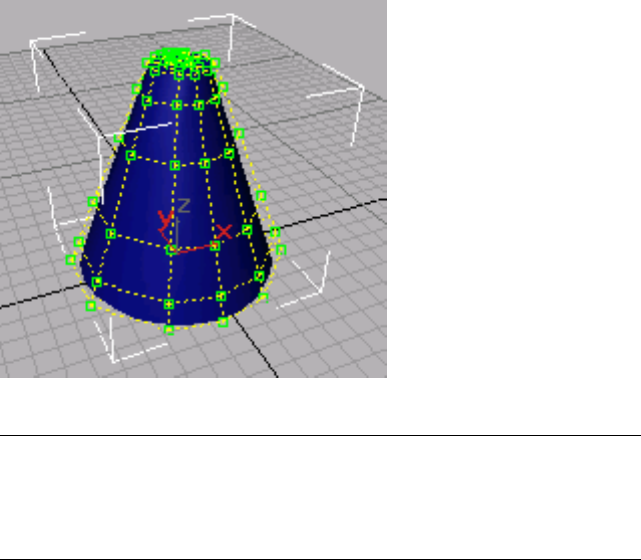
CV Curves and CV Surfaces
CV curves and CV surfaces have control vertices (CVs) as do splines. The
position of the CVs controls the shape of the curve or the surface. However,
unlike spline vertices, CVs don’t necessarily lie on the curve or surface they
define. The CVs define a control lattice on page 7745 that connects the CVs
and surrounds the NURBS curve or surface. The control lattice displays in lines
that are yellow by default.
Cone-shaped NURBS surface with its control lattice (CVs are displayed as green squares)
TIP When you use Zoom Extents, the entire extents of a NURBS object are
displayed, including its control lattice. Because CVs can be located some distance
from an object, the curve or surface itself (the object’s renderable geometry) is
sometimes hard to see. If this happens, use Zoom Region or Field of View to zoom
in.
You can move a CV at the Curve CV or Surface CV sub-object level on the
Modify panel. Other transforms, rotate and scale, work as well. Rotate and
scale are useful mainly when you have selected multiple CVs.
2166 | Chapter 10 Surface Modeling
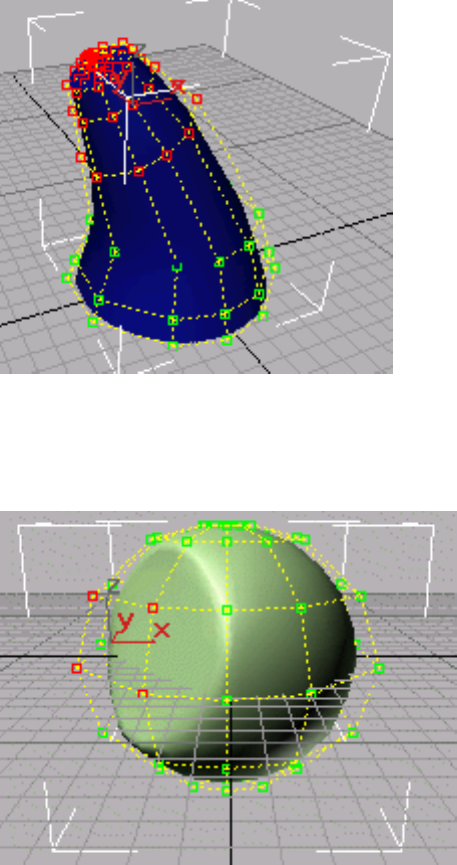
Moving and rotating CVs to change a surface (selected CVs are displayed in red)
Each CV also has a weight, which you can use to adjust the CV’s effect on the
curve or surface. Increasing the weight pulls the surface toward the CV.
Decreasing the weight relaxes the surface away from the CV.
NURBS Models: Objects and Sub-Objects | 2167
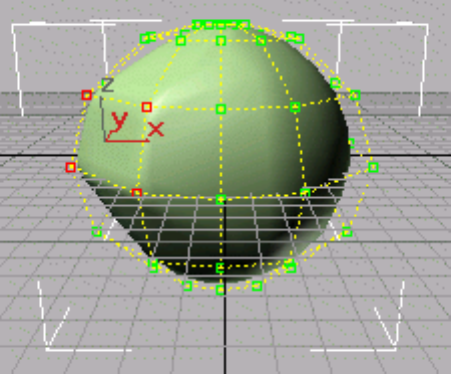
Above: Weights=0.0
Below: Weights=40.0
Changing a spherical surface by decreasing or increasing the weight of four CVs
(selected CVs are at the left, in red)
Weights can be a useful way to "tune" the appearance of a NURBS curve or
surface.
The weight value of a CV is rational (as in a "rational number"). That is, it is
relative to other CVs in the curve or surface. Changing the weight of all CVs
at once has no effect, because it doesn’t change the ratio between weights.
Points, Point Curves, and Point Surfaces
Point curves and point surfaces are similar to CV curves and surfaces, but the
points that control them are required to lie on the curve or surface. Unlike
CVs, points do not have a weight.
Point curves and point surfaces can be more intuitive to create and work with.
However, working with point sub-objects is slower than working with CV
sub-objects. You can think of a point curve or point surface as being dependent
on the points to which it fits.
Points that you create individually are the same as the points on point curves
and surfaces, except that initially they aren’t part of a curve or surface. You
can create a point curve by fitting it to points that you select. When you fit
the new point curve, you can use points that are part of curves or surfaces,
and individual point sub-objects.
2168 | Chapter 10 Surface Modeling
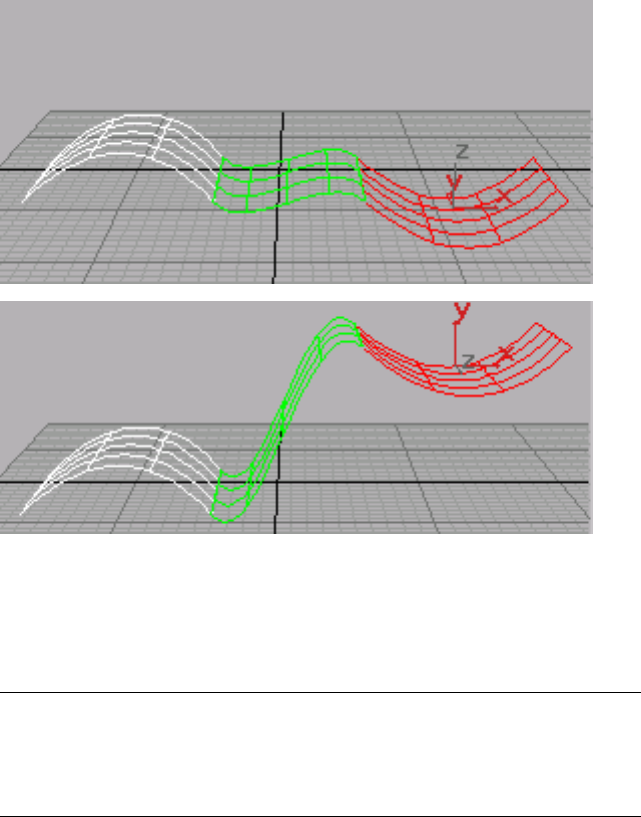
Dependent Sub-Objects
NURBS sub-objects are either independent or dependent. A dependent
sub-object is based on the geometry of other sub-objects. For example, a blend
surface smoothly connects two other surfaces. Transforming or animating
either of the original, parent surfaces causes the shape of the blend to change
as it maintains a connection between the parents.
Moving a parent surface changes the blend surface (the blend surface is displayed in
green)
The immediate, interactive relation between the parent and dependent
sub-objects is known as relational modeling. Relational modeling is one of the
reasons NURBS models can be particularly easy to change or to animate.
IMPORTANT Dependent sub-objects must have parents that are also sub-objects
of the same NURBS model. Dependent relationships can’t exist between object-level
NURBS curves or surfaces. If you want to use a top-level NURBS object to create
a dependent object, first you must attach or import the top-level object. See
Attaching and Importing 3ds Max Objects on page 2225 .
NURBS Models: Objects and Sub-Objects | 2169
You have the option of making a dependent sub-object independent. After
you do so, the sub-object is no longer related to its parents. Changes to the
former parents don’t affect it, but you can edit and transform it as an
independent sub-object in its own right.
At the appropriate sub-object level, dependent NURBS are displayed in green
in wireframe viewports. (You can change the display color using the Colors
panel of the Customize User Interface dialog on page 7489 .)
Relational modeling does add computation time to a model, so when you
transform or edit dependent sub-objects in other ways, often you will notice
a slowdown in performance. Once a dependent surface sub-object has the
shape you want, you can improve performance by making it into a rigid
surface on page 2172 .
Transforming Dependent Sub-Objects
In general, you can select and transform dependent sub-objects, but the effect
of the transform depends on the sub-object type. Some dependent objects
have a gizmo, similar to the gizmo used with modifiers. Sub-objects that don’t
have gizmos can’t change relative to their parent objects. For these kinds of
sub-objects, transforms apply equally to the sub-object and its parents. For
example, moving a blend sub-object moves its parents as well. Sub-objects
that have gizmos can change relative to their parent objects. In this case, as
with modifiers that use gizmos, you are really transforming the gizmo. For
example, rotating a mirror sub-object changes the mirror axis, and therefore
the mirror’s position relative to its parent curve or surface.
When you Shift+Clone on page 2466 a dependent NURBS sub-object, by default
the parent objects are also cloned. For example, if you Shift+Clone a UV loft,
all the lofting curves are copied as well. This means that the new object has
the same type as the original object. The cloned object keeps its parents, so
you can edit it just as you do the original. When you Shift+Clone a NURBS
sub-object, you can also choose to remove dependencies in order to improve
performance.
Error Condition for Dependent Sub-Objects
Sometimes changes you make to the parent objects make it no longer possible
to correctly update the dependent object’s geometry. For example, a fillet
between two curves requires the curves to be coplanar. If you move one curve
(or its CVs or points) so that the curves are no longer coplanar, the fillet cannot
update correctly. In this case, the dependent object’s geometry reverts to a
default position, and it is displayed in orange to indicate an error condition.
2170 | Chapter 10 Surface Modeling
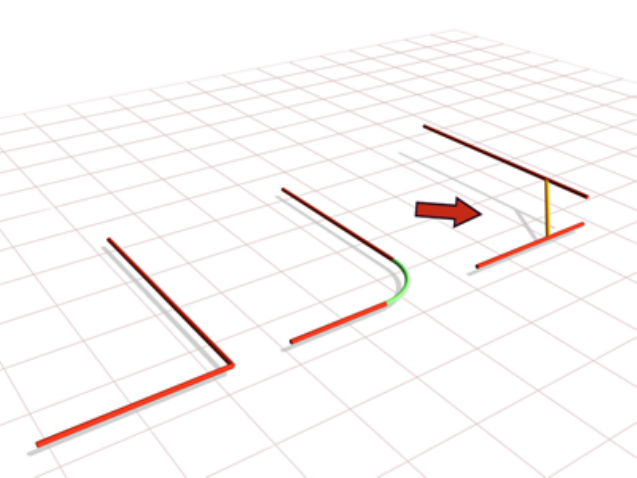
(You can change the error color using the Colors panel on page 7505 of the
Customize User Interface dialog on page 7489 .)
The arrow points to the segment indicating an error condition.
Seed Values
Some kinds of dependent sub-objects depend on geometry that might have
more than one solution. For example, if you want to create a surface-curve
intersection point, and the curve intersects the surface more than once, the
software must decide which intersection is to be the location of the point.
For these kinds of objects, seed value on page 7922 parameters control the
decision. The seed location is on a parent object, and the software chooses
the location nearest to the seed value that satisfies the creation condition.
You can alter the seed value when you edit these dependent sub-objects. The
seed location is displayed as a yellow square.
For example, the seed location for a surface-curve intersection point is a U
position along the length of the parent curve. The surface-curve intersection
closest to the seed is chosen as the location of the dependent point.
The seed location for a surface is a pair of UV coordinates in the surface's
parameter space on page 7882 .
NURBS Models: Objects and Sub-Objects | 2171
Replacing Parent Sub-Objects
Dependent sub-objects have controls that let you replace the object or objects
on which they depend. For example, Offset Surface has a button called Replace
Base Surface. You can click this button and then click a different surface to
act as the base of the offset.
This capability lets you replace a trimmed surface with its untrimmed version,
or vice versa. To do so, you need to use the Select Sub-Objects dialog, which
is a subset of the Selection Floater on page 171 that you can use during
sub-object creation as well as sub-object selection. For example, select the
trimmed surface sub-object and turn on the Keyboard Shortcuts Override
toggle on page 7646 . Click the replacement button, press the H key, expand the
surface's tree, and then highlight the name of the untrimmed version.
Rigid Surfaces
To improve performance, you can make any kind of surface sub-object into
a rigid surface. The only editing allowed on a rigid surface is to transform it
at the Surface sub-object level. You can't move a rigid surface's points or CVs,
or change the number of points or CVs.
Rigid surfaces reduce the amount of memory used by the NURBS model.
Making surfaces rigid improves performance, especially for large and complex
models.
When a surface is rigid, you can't see its points or CVs when you are at the
Point or Surface CV sub-object levels. If the model has only rigid surfaces and
no point curves, the Point and Surface CV sub-object levels aren't available at
all.
To make a rigid surface editable again, click Make Point, Make Independent,
Make Loft, or Convert Surface.
NURBS and Modifiers
In general, you can apply modifiers to NURBS models as you do to other
objects.
You can apply Edit Patch on page 1290 and Edit Mesh on page 1283 modifiers
to NURBS surface objects.
2172 | Chapter 10 Surface Modeling
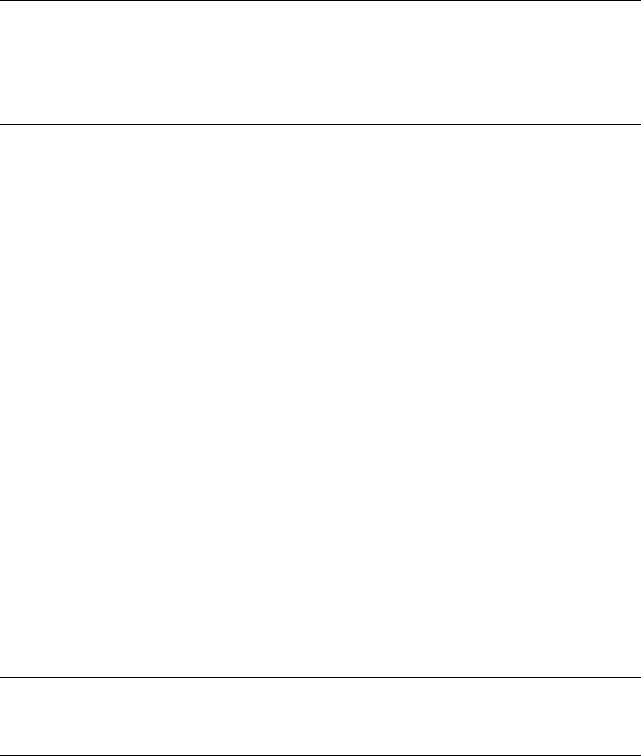
TIP To improve performance while you animate your scene, make the surfaces in
your NURBS model nonrelational surfaces on page 2219 . Modifiers treat
nonrelational surfaces as if they were independent CV surfaces: you can animate
the scene more efficiently, and then turn relational modeling back on before you
render.
Deforming NURBS Objects
Deform modifiers such as Bend on page 1139 and Twist on page 1765 operate
on CV and point sub-objects. They don't change the NURBS model into an
editable mesh object. This means that you can use a deform modifier, collapse
the stack, and still have a NURBS object that you can edit further. However,
because the deform modifiers directly affect CVs and points (and not the mesh
approximation of the NURBS model), they can produce unexpected results.
For example, a Ripple on page 1583 modifier does not ripple the surface if the
CVs are farther apart than the wavelength of the ripples. If you want the
modifier to affect the mesh approximation instead of the CVs, you can apply
a Mesh Select on page 1455 modifier first. Then when you collapse the stack,
you get an editable mesh, not a NURBS object.
These are the deform modifiers that collapse to NURBS:
■Modifiers in the Parametric Deformers set, except for Lattice (which
collapses to an editable mesh) and Slice (which collapses to an editable
poly or an editable mesh).
■Modifiers in the Animation Modifiers set, except for the world-space
modifier (WSM) versions of PatchDeform, PathDeform, and SurfDeform,
which don't collapse.
TIP While the Morpher and Skin modifiers collapse to a NURBS object, they are
meant to be used with their own controls, and lose their usefulness when you
collapse them.
The modifiers with Soft Selection controls treat NURBS models the same way
they treat editable meshes. As with editable mesh vertices, CVs are colored
proportionally according to how much the region affects them.
If Relational Stack is turned off (see Nonrelational NURBS Surfaces on page
2219 ), the Affect Neighbors toggle can affect all surface CVs, curve CVs, and
points in neighboring sub-objects. If Relational Stack is on, Soft Selection
affects neighboring sub-objects only if they are at the same sub-object level.
Soft Selection works with Scale and Rotate as well as with the Move transform.
NURBS Models: Objects and Sub-Objects | 2173

NURBS Objects and the UVW Map Modifier
When you apply a UVW Map on page 1849 modifier, it affects the NURBS
object the same way it affects a mesh. If you then collapse the stack, UVW
mapping is still in effect. However, you can override the mapper for individual
surface sub-objects. To do so, turn on the surface's Generate Mapping Coords
check box, if necessary. When the check box is on, you get the natural mapping
of the surface; when it is off, you get the mapping from the collapsed UVW
modifier.
TIP Don't use UVW Map to assign a texture to an animated surface. The texture
will shift as the surface animates.
NURBS Selection Modifier
The NURBS Surface Selection (NSurf Sel) on page 1513 lets you place a NURBS
sub-object selection on the modifier stack. This lets you modify only the
selected sub-objects. Also, selected curve sub-objects are Shape on page 536
objects that you can use as paths and motion trajectories.
NSurf Sel can select any kind of NURBS sub-object except imports. Each
sub-object selection is of one sub-object level only.
Procedures
To use a NURBS select modifier:
1With a NURBS object selected, go to the Modify panel and apply NSurf
Sel.
The selection modifier has no controls at the object level.
2Click to open the modifier's hierarchy, and choose a sub-object level.
The selection modifier has the same selection controls you see for the
corresponding sub-object type.
While applying the modifier, you can also select NURBS sub-objects by
name. Turn on the Keyboard Shortcut Override Toggle button on the
status bar, and then press the H key. This open the Select Sub-Objects
dialog, which is a subset of the Selection Floater on page 171 that you
can use during sub-object creation as well as sub-object selection. Choose
one or more objects in the list, and then click Select. Press Ctrl+H to have
the Select Sub-Objects dialog list only sub-objects (for example, points)
directly under the mouse cursor.
2174 | Chapter 10 Surface Modeling
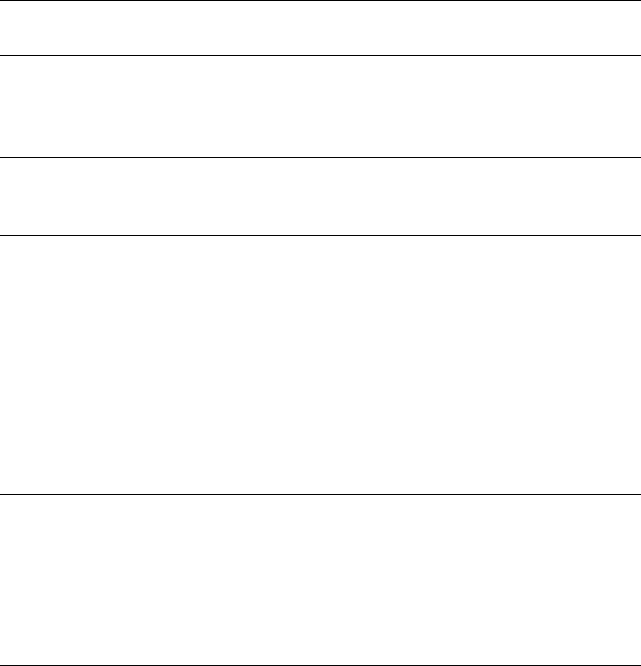
3Use the selection controls to create a selection set of the chosen sub-object
type.
With the NSurf Sel modifier, you can select NURBS sub-objects at any
level except imports.
NOTE To select point, curve, or curve CV sub-objects, you must go to the NURBS
object and turn on Relational Stack.
Once you have used the modifier to create the selection, you can apply other
modifiers to it. If the selected sub-object is a curve, you can also use it as a
path or trajectory.
NOTE NSurf Sel doesn't support copy and paste of selections as Mesh Select does.
Copying and pasting mesh selections is based on vertex indexes. NURBS selections
are based on object IDs, which are unique to each model.
NURBS and Animation
In general, you animate NURBS curves and NURBS surfaces by turning on the
Auto Key button and transforming sub-object attributes such as CV or point
positions, by animating the parameters that control dependent NURBS objects,
and so on. You can't animate NURBS object creation or creation parameters,
or fundamental changes to NURBS geometry such as adding or deleting CVs
or points, attaching objects, and so on.
TIP To improve performance while you animate your scene, make the surfaces in
your NURBS model nonrelational surfaces on page 2219 . Modifiers treat
nonrelational surfaces as if they were independent CV surfaces: you can animate
the scene more efficiently, and then turn relational modeling back on before you
render.
Some NURBS editing operations remove animation controllers.
Operations that Remove Animation
The following operations remove animation from a NURBS object or sub-object:
■Make Independent
This operation removes the animation of anything directly dependent on
the object.
NURBS Models: Objects and Sub-Objects | 2175
■Break, Extend, Join and Zip, Refine, Delete, Rebuild, Reparameterize, Close,
Make Loft, Convert Curve, and Convert Surface
Any operation that changes the number of points or CVs in a curve or
surface removes the animation of all points or CVs that are lost.
■Fuse
The animation of the point or CV being fused to the other point or CV
(the second one chosen) is lost. The first point or CV acquires the animation
of the second.
NURBS Concepts
NURBS curves and surfaces did not exist in the traditional drafting world.
They were created specifically for 3D modeling using computers. Curves and
surfaces represent contours or shapes within a 3D modeling space. They are
constructed mathematically. NURBS mathematics is complex, and this section
is simply an introduction to some NURBS concepts that might help you
understand what you are creating, and why NURBS objects behave as they
do. For a comprehensive description of the mathematics and algorithms
involved in NURBS modeling, see The NURBS Book by Les Piegl and Wayne
Tiller (New York: Springer, second edition 1997).
Definition and Parameter Space
The term NURBS stands for Non-Uniform Rational B-Splines. Specifically:
■Non-Uniform means that the extent of a control vertex's influence can vary.
This is useful when modeling irregular surfaces.
■Rational means that the equation used to represent the curve or surface is
expressed as a ratio of two polynomials, rather than a single summed
polynomial. The rational equation provides a better model of some
important curves and surfaces, especially conic sections, cones, spheres,
and so on.
■A B-spline (for basis spline) is a way to construct a curve that is interpolated
between three or more points.
Shape curves such as the Line tool and other Shape tools are Bezier curves,
which are a special case of B-splines.
The non-uniform property of NURBS brings up an important point. Because
they are generated mathematically, NURBS objects have a parameter space
on page 7882 in addition to the 3D geometric space in which they are displayed.
2176 | Chapter 10 Surface Modeling
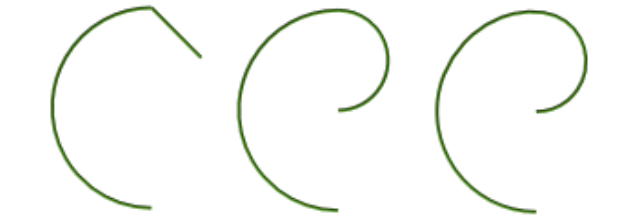
Specifically, an array of values called knots on page 7825 specifies the extent
of influence of each control vertex (CV) on the curve or surface. Knots are
invisible in 3D space and you can't manipulate them directly, but occasionally
their behavior affects the visible appearance of the NURBS object. This topic
mentions those situations. Parameter space is one-dimensional for curves,
which have only a single U dimension topologically, even though they exist
geometrically in 3D space. Surfaces have two dimensions in parameter space,
called U and V.
NURBS curves and surfaces have the important properties of not changing
under the standard geometric affine transformations (Transforms), or under
perspective projections. The CVs have local control of the object: moving a
CV or changing its weight does not affect any part of the object beyond the
neighboring CVs. (You can override this property by using the Soft Selection
on page 2275 controls.) Also, the control lattice that connects CVs surrounds
the surface. This is known as the convex hull on page 7747 property.
Degree and Continuity
All curves have a degree on page 7755 . The degree of a curve is the highest
exponent in the equation used to represent it. A linear equation is degree 1;
a quadratic equation is degree 2. NURBS curves typically are represented by
cubic equations and have a degree of 3. Higher degrees are possible, but usually
unnecessary.
Curves also have continuity on page 7743 . A continuous curve is unbroken.
There are different levels of continuity on page 7744 . A curve with an angle or
cusp is C0 continuous: that is, the curve is continuous but has no derivative
at the cusp. A curve with no such cusp but whose curvature changes is C1
continuous. Its derivative is also continuous, but its second derivative is not.
A curve with uninterrupted, unchanging curvature is C2 continuous. Both its
first and second derivatives are also continuous.
Levels of curve continuity:
Left: C0, because of the angle at the top
NURBS Models: Objects and Sub-Objects | 2177
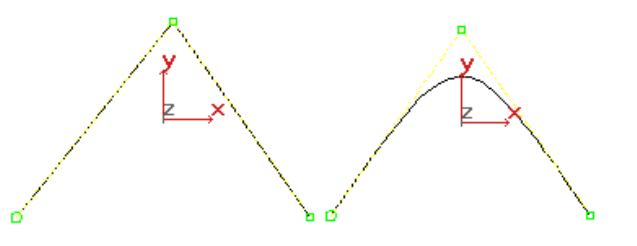
Middle: C1, at the top a semicircle joins a semicircle of smaller radius
Right: C2, the difference is subtle but the right side is not semicircular and blends
with the left
A curve can have still higher levels of continuity, but for computer modeling
these three are adequate. Usually the eye can't distinguish between a C2
continuous curve and one with higher continuity.
Continuity and degree are related. A degree 3 equation can generate a C2
continuous curve. This is why higher-degree curves aren't generally needed
in NURBS modeling. Higher-degree curves are also less stable numerically, so
using them isn't recommended.
Different segments of a NURBS curve can have different levels of continuity.
In particular, by placing CVs at the same location or very close together, you
reduce the continuity level. Two coincident CVs sharpen the curvature. Three
coincident CVs create an angular cusp in the curve. This property of NURBS
curves is known as multiplicity on page 7858 . In effect, the additional one or
two CVs combine their influence in that vicinity of the curve.
Effects of multiplicity: there are three CVs at the apex on the left, two CVs at the apex
on the right.
By moving one CV away from the other, you increase the curve's continuity
level again. Multiplicity also applies when you fuse CVs. Fused CVs create a
sharper curvature or a cusp in the curve. Again, the effect goes away if you
unfuse the CVs and move one away from the other.
Degree, continuity, and multiplicity apply to NURBS surfaces as well as to
curves.
Refining Curves and Surfaces
Refining a NURBS curve means adding more CVs. Refining gives you finer
control over the shape of the curve. When you refine a NURBS curve, the
2178 | Chapter 10 Surface Modeling

software preserves the original curvature. In other words, the shape of the
curve doesn't change, but the neighboring CVs move away from the CV you
add. This is because of multiplicity: if the neighboring CVs didn't move, the
increased presence of CVs would sharpen the curve. To avoid this effect, first
refine the curve, and then change it by transforming the newly added CVs,
or adjusting their weights.
Refining a NURBS curve.
NURBS surfaces have essentially the same properties as NURBS curves, extended
from a one-dimensional parameter space to two dimensions.
Reparameterizing CV Curves and Surfaces
When you refine a NURBS curve or surface, it is a good idea to reparameterize
it. Reparameterizing adjusts the parameter space so the curve or surface will
behave well when you edit it in viewports. There are two ways to
reparameterize:
■Chord-length
Chord-length reparameterization spaces knots in parameter space based
on the square root of the length of each curve segment.
■Uniform
Uniform reparameterization spaces knots uniformly. A uniform knot vector
has the advantage that the curve or surface changes only locally when you
edit it.
CV curve and surface sub-objects give you the option of reparameterizing
automatically whenever you edit the curve or surface.
Point Curve and Surface Concepts
You can work with point curves and point surfaces as well as with CV curves
and surfaces. The points that control these objects are constrained to lie on
the curve or surface. There is no control lattice, and no weight control. This
is a simpler interface that you might find easier to work with. Also, point-based
NURBS Models: Objects and Sub-Objects | 2179
objects give you the ability to construct curves based on dependent
(constrained) points, and then use these to construct dependent surfaces.
You can think of point curves and surfaces as an interface to CV curves and
surfaces, which are the fully defined NURBS objects. The underlying
representation of the curve or surface is still constructed using CVs.
You can also think of a point curve or surface as dependent on its points. You
can use the Convert Curve button to convert a point curve or surface to the
CV form, or vice versa.
NURBS Tips and Techniques
These topics contain suggestions on how to work with NURBS. They include
tips collected from various NURBS modeling users.
How to Make Objects with NURBS Modeling on page 2180
How to Fix NURBS Objects on page 2186
How to Improve Performance on page 2188
Animation, Textures, and Rendering on page 2189
How to Make Objects with NURBS Modeling
These are tips on using NURBS to create models.
Objects and Sub-Objects
■In 3ds Max, a NURBS model is a single, top-level NURBS object on page
2153 that can contain a variety of sub-objects. Get in the habit of creating
a single object at the top level, then going immediately to the Modify
panel and adding sub-objects by using rollouts or the NURBS Creation
Toolbox on page 2162 .
■Sub-objects are either independent or dependent. Dependent sub-objects
on page 2169 use relational modeling to build NURBS geometry that is
related to other geometry. However, understand that the more
dependencies a model has, the slower interactive performance becomes.
■In general, point curves and surfaces are slower than CV curves and surfaces.
Trims are the slowest kind of dependency, and texture surfaces are the
slowest kind of dependent sub-object.
2180 | Chapter 10 Surface Modeling
■If a dependent sub-object doesn't change during animation, you can
improve performance by making the sub-object independent after you
finish creating it.
■You can use NSurf Sel on page 1513 to apply modifiers to a sub-object
selection. However, before you do so make sure that Relational Stack is on;
Relational Stack on page 2219 is on the General rollout for NURBS models.
Otherwise, NSurf Sel can select only the Surface and Surface CV sub-object
levels.
Converting Other Objects to NURBS
■Remember that you can collapse splines on page 542 to NURBS objects. A
spline Shape or a NURBS curve can be a good starter object for a NURBS
model.
■Shapes with sharp angles collapse to multiple NURBS curves. You can
control this before NURBS conversion by first converting the Shape to an
editable spline on page 590 . Modify the editable spline so that all its vertices
are Bezier or Smooth vertices. Then when you collapse the spline to a
NURBS curve, you obtain a single curve.
■If you want a single NURBS curve, don't change vertices to Bezier Corner
vertices. These always convert to a junction between two different NURBS
curves.
■Collapsing a primitive on page 348 into a NURBS object is one of the
quickest ways to start building a NURBS model. After collapsing the
primitive, you can select various CVs and transform them. Other objects
you can convert to NURBS are prisms on page 423 , torus knots on page
389 , lofts on page 715 , and patch grids on page 1982 .
■You can also change the NURBS surface by applying modifiers. The
modifiers act on the points or CVs of the surface, and not on the surface
itself. After applying the modifiers, collapse the modifier stack on page
7427 . This removes the modifiers from the stack without changing the
position of the modified points or CVs, making for a simpler and quicker
model.
■Another way to create a NURBS surface object is to apply a Lathe on page
1430 or Extrude on page 1377 modifier to a NURBS curve. Set the modifier's
Output Type to NURBS, and then collapse when you're done adjusting the
parameters.
(There are also NURBS lathe and extrude surface sub-object types, which
you can apply to curve sub-objects.)
NURBS Models: Objects and Sub-Objects | 2181
Shortcuts, Snaps, and User Interface Tips
■Remember to turn on the Plug-In Keyboard Shortcut Toggle on page 7646
. While it is on, you can use all the NURBS keyboard shortcuts.
■One of the most useful NURBS keyboard shortcuts is H, which opens the
Select Sub-Objects dialog. This is a subset of the Selection Floater on page
171 that you can use during sub-object creation as well as sub-object
selection. This is handy when sub-objects are crowded or hard to see.
A variant is Ctrl+H, which also displays the Select Sub-Objects dialog, but
lists only those NURBS sub-objects beneath the mouse cursor position.
■There are special NURBS Snaps in the Grid and Snap Settings dialog on
page 2577 (right-click the 3D Snap toggle to display this). When you use
NURBS snaps, turn off Options/Axis Constraints; otherwise, snaps work
only in the current axis.
Also, remember that snaps work in a viewport only when you have made
the viewport active. And choosing your snap settings does not turn on
snaps. You must also turn on the 3D Snap Toggle button on page 2568 (on
the status bar).
Snaps are especially important when you create the curves for building
1-rail on page 2397 and 2-rail on page 2407 sweep surfaces.
■Remember that without leaving the viewport, you can right-click to display
a quad menu on page 7300 with shortcuts for changing the sub-object level,
creating some sub-objects, and using some other edit commands.
■When you work with NURBS, there are a lot of rollouts in the Modify
panel. Minimize the rollouts you don't need. For example, minimizing the
Modifiers rollout helps unless you're applying Modifiers, and minimizing
the Surface Common rollout is useful when you're creating U loft, UV loft,
and 1-rail or 2-rail sweep surfaces.
■Don't set viewports to display edged faces. Displaying edges is almost twice
as slow as displaying a simple shaded viewport.
Creating Curves
■When drawing a CV curve, click three times to get a sharp corner.
Be aware, however, that multiple CVs increase the amount of calculation
and therefore reduce the performance and stability of your model. However,
if you want to use the curve to construct a U Loft, and so on, this is the
best technique.
2182 | Chapter 10 Surface Modeling
■You can also create sharp corners by fusing the ends of two separate NURBS
curve sub-objects. This is the recommended method if you aren't using
the curves to construct a surface.
■While creating curves, you can turn on the Draw in All Viewports toggle.
This lets you draw curves in 3D. Begin drawing a curve in one viewport,
go to another viewport, and continue drawing.
If your mouse has a middle mouse button, Alt+middle mouse button lets
you use arc rotate on page 7395 to change a viewport's orientation while
you are creating the curve.
■To create a transform curve along a specific axis, turn on the appropriate
axis constraints, and then Shift+move a copy of the transform curve.
Curves and Direction
■NURBS curves show their direction in viewports. A small circle indicates
the first vertex. If the curve is closed, a plus sign (+) indicates the direction
of the curve.
Be aware of curve direction when you use curves to construct blend surfaces
on page 2348 , U loft on page 2380 and UV loft on page 2390 surfaces, and
1-rail on page 2397 and 2-rail on page 2407 sweeps. If the curves don't have
the same direction, you can get strange twisting. Make sure curves have
the same direction before you construct the surface. On the Curve Common
rollout, the controls Reverse and Make First let you control the direction
of the curve, and where its starting point or CV is located.
Another good way to make sure curves are aligned is to draw one curve
and then use Shift+Clone to create the others. After creating the aligned
curves, you can transform CVs to vary the curves on which the surface
will be based.
Curves for Sweeps
■Besides expecting cross-section curves to be all in the same direction, 1-rail
on page 2397 and 2-rail on page 2397 sweep surfaces work best if the cross
sections intersect the rail or rails. To achieve this, draw the rails first, then
draw the cross sections using the NURBS Snaps on page 2578 Curve End
and Curve Edge turned on.
■2-rail sweeps have the additional requirement that the endpoints of the
first cross section intersect the endpoints of the rails. Again, NURBS Snaps
help you do this.
NURBS Models: Objects and Sub-Objects | 2183
If the endpoints of the first cross-section don't coincide with the rail
endpoints, the resulting surface might not follow the rails.
■While you're editing a sweep, the Edit Curve button lets you directly
transform the CVs of a rail or cross section, without changing the sub-object
level. Edit Curve also gives you access to all the rollouts that control the
curve. You can use Refine or Make First, for example, without changing
levels.
Curves on Surfaces and Projected Curves
■You can use a viewport to draw a curve on a surface on page 2327 (COS),
but this works only for visible portions of the surface. To see the entire
surface and the curve or curves on it projected into a flat plane, use Edit
Curve.
If your mouse has a middle mouse button, Alt+middle mouse button lets
you use arc rotate on page 7395 to change a viewport's orientation while
you draw the curve on surface.
■Neither curves on surfaces nor projected curves can cross the edge of a
surface. This includes the seam on surfaces with fused CVs. If you try to
project across the seam, only part of the curve's projection is created.
Creating Blend Surfaces
■You can blend between curves or between surface edges. (You can't blend
from a trimmed edge. In that situation, you are blending from the curve
that trimmed the surface.)
■If you want a controllable tangent or tension, you must blend to a surface
edge or a curve on a surface. Adjusting tension changes the flatness or
"bulginess" of that end of the blend.
When a curve and a surface (or two surfaces) are near each other, sometimes
it can be hard to tell which edge you are selecting. To assist you, the
currently selected surface turns yellow, and the edge that will be used for
the blend turns blue. Make sure you have selected the right surface before
you choose the edge.
■If the edges you are blending have different numbers of points (usually
due to different surface approximation settings), then sometimes rendering
shows gaps between the blend and the original surface. If this happens,
go to the Surface Approximation rollout on page 2469 and increase the
value of Merge until the gaps disappear when you render.
2184 | Chapter 10 Surface Modeling
The Merge setting affects only the production renderer. It has no effect on
viewport display.
Lofts
■If you need a surface between only two curves, use a ruled surface on page
2374 instead of a U loft. This is faster.
■If loft creation seems slow, make sure the Display While Creating check
box (in the U Loft Surface rollout on page 2380 ) is turned off.
■If the U loft doesn't come out as you expected, try reparameterizing the
curves. Click Reparam. at the Curve sub-object level. This button is on the
CV Curve rollout. In the Reparameterize dialog on page 2465 , choose Chord
Length reparameterization.
If a curve is dependent or a point curve, first you will have to make it
independent (this also improves performance).
Curves that are made of two joined curves have this problem more often
than others. If you have a joined curve as one of the curves to construct
the loft, reparameterize it before you create the loft, or set the curves to
reparameterize automatically.
■The Edit Curve button lets you directly transform the CVs of a curve within
a U loft or UV loft on page 2390 , without changing the sub-object level.
Edit Curve also gives you access to all the rollouts that control the curve.
You can use Refine or Make First, for example, without changing levels.
■To close a UV loft, you can pick the first V curve again to make it the last
curve in the loft. Sometimes a seam is visible at this location in the UV
loft.
Multisided Blend Surfaces
■If the program doesn't create the multisided blend on page 2417 , fuse the
CVs at the three or four corners. Snapping CVs to each other doesn't always
succeed, because of rounding off.
Multicurve Trimmed Surfaces
■Multicurve trimmed surfaces are the only way to create a trimmed hole
that contains sharp angles.
NURBS Models: Objects and Sub-Objects | 2185
Displacement Mapping
■In general, the default tessellation settings aren't suitable for displaced
surfaces. With these default settings, displacement mapping can create an
extremely high face count, which performs very slowly. Change the surface
approximation to the lowest necessary resolution. A good rule of thumb
is to start with Spatial approximation and an Edge value of 20. If that is
too low, reduce the Edge value until the model looks as it should.
■Use the Displace NURBS world space modifier on page 1047 to convert the
displacement map into an actual displaced mesh so you can see the effect
of displacement in viewports. To make a displaced mesh copy of the NURBS
model, use Snapshot on page 921 .
Connecting an Arm to a Shoulder
■The easiest approach is to create a CV curve on surface on page 2327 or
normal projected curve on page 2320 on the shoulder. Then create the arm
as a U loft on page 2380 . For the last curve of the U loft, select the CV curve
on surface or the normal projected curve. Then turn on Use COS Tangents,
which makes the loft surface tangent to the other surface where the arm
joins the shoulder.
■If the blend appears twisted, use the Start Point spinner to change the
location of the first point of the curves that make up the U loft surface.
■Another way to connect a U loft to another surface is to project the last
curve in the U loft onto the other surface. Click Make COS to convert the
projected curve into a curve on surface, and then on the U Loft Surface
rollout click Insert to make the new curve on surface the last curve in the
U loft. You can scale the curve on surface or move its CVs to get the
curvature and blending you want.
How to Fix NURBS Objects
These are tips on fixing problems with NURBS models.
■If you create a surface but it isn't visible in viewports, click Flip Normals.
Flip Normals is available on the surface's creation rollout, or at the Surface
sub-object level on the Surface Common rollout.
2186 | Chapter 10 Surface Modeling
■If you create a blend surface on page 2348 and it looks like a bow tie, use
Flip End 1 or Flip End 2 to correct the twist.
■If a CV curve gives you unexpected or incorrect results, try reparameterizing
it. Click Reparam. at the Curve sub-object level. This button is on the CV
Curve rollout. In the Reparameterize dialog on page 2465 , choose Chord
Length reparameterization.
If the curve still gives you trouble, try rebuilding it. The Rebuild button is
on the same rollout.
■If a blend between a surface and a curve gives you unexpected or incorrect
results, try reparameterizing the parent surface. Click Reparam. at the
Surface sub-object level. This button is on the CV Surface rollout. In the
Reparameterize dialog on page 2465 , choose Chord Length
reparameterization.
■If you see a seam in a shaded viewport, render the viewport first before
you try to fix the seam. What you see in viewports might not be what you
get in a render, and the viewport shader is less accurate than the production
renderer. Seams in viewports can also result from different surface
approximation settings on page 2469 for the viewport and the renderer, so
check these as well.
■If you see gaps between faces in the rendered model, increase the Merge
value for the renderer in the surface approximation settings.
■Sometimes gaps between faces appear after you convert a NURBS model
into a mesh. (For example, by using Mesh Select on page 1455 .) If this
happens, increase the Merge value for the renderer in the surface
approximation on page 2469 settings.
■If you see odd twists in a 1-rail on page 2397 or 2-rail on page 2407 sweep,
add more cross sections at the areas of change in the surface. For example,
if your rail looks like a box with rounded corners, placing cross sections
at the corners helps to control the shape of the sweep. On the other hand,
you don't need more cross sections for a rail shaped like an 'S', because the
curvature is more constant.
■If a U loft or UV loft doubles back on itself unexpectedly, make sure that
all the curves are going in the same direction. Click Reverse to change a
curve's direction. Use the Start Point spinner to align the curve's initial
points.
NURBS Models: Objects and Sub-Objects | 2187
How to Improve Performance
These are tips on improving the performance of your NURBS models.
■Avoid using point curves and point surfaces. These are slower than CV
curves and CV surfaces. Use the point forms only when you need them
for construction; for example, when you use Curve Fit to create a curve
that interpolates specific points.
■Use the nonrelational stack on page 2219 feature in conjunction with the
Shaded Lattice toggle to improve performance while you animate your
NURBS model.
■Use Transform Degrade to hide surfaces while you are moving, rotating,
and scaling NURBS sub-objects. The shortcut Ctrl+X toggles this option.
You can use Ctrl+X in the middle of a transform, to turn on degradation
if things are happening slowly.
■Turn off the display of dependent surfaces while you are creating new
dependent surfaces or moving, rotating, or scaling NURBS sub-objects. The
shortcut Ctrl+D toggles dependent surface display.
■Trim holes only when you need to. For example, when you connect an
arm to a torso, you don't need to create a hole beneath the arm, as it won't
be visible anyway.
You can also speed up performance by turning off the Display Trims toggle.
The shortcut Shift+Ctrl+T toggles trim display. The trims still appear in
renderings.
■For symmetrical models, create only half the geometry, and then mirror
it. You can then use a blend on page 2348 surface or ruled on page 2374
surface to connect the two halves.
■Restart 3ds Max when performance begins to slow down. If your NURBS
model needs to page, then working with it for a long time causes
performance to slow. If you notice this, save your work, close 3ds Max,
and then restart.
■Convert point surfaces to CV surfaces whenever possible.
■When you use texture surfaces, use the Edit Texture Surface dialog on
page 2453 (click Edit Texture Surface on the Material Properties rollout on
page 2278 ) to rebuild the texture surface with the minimum necessary
number of UV rows and columns.
■U lofts are faster than UV lofts.
2188 | Chapter 10 Surface Modeling
■Every type of surface is faster if you can make it independent.
■Set the surface approximation on page 2469 for viewports to use the lowest
possible resolution. Set the renderer to use higher resolution, and turn on
View Dependent for the renderer so objects far from the camera render
more quickly.
■You can customize and save surface approximation on page 2469 presets
by using the Surface Approximation utility on page 2480 . This utility also
lets you set surface approximation values for a selection set of multiple
NURBS models.
Animation,Textures, and Rendering
These are tips about animating NURBS models and using textures with
animated NURBS models.
■An easy way to animate a growing surface is to put a curve point on page
2432 with trimming on a curve, then animate the U position of the curve
point, and then use this curve as the rail of a 1-rail sweep on page 2397 . As
the trimmed rail grows, so does the sweep surface. (You must trim the
curve before you create the sweep surface.)
■If you see gaps between surfaces in rendered images, increase the value of
Merge for the renderer in the surface approximation on page 2469 settings.
■If a texture slides around on the surface during animation, this is because
you are using the default Chord-Length parameterization of the texture
surface. Select the surface, then on the Material Properties rollout on page
2278 change the parameterization to User Defined. Now the texture should
stick to the surface better.
■Don't use the UVW Map modifier on page 1849 to apply a texture to an
animated NURBS surface.
■If a surface seems to glitter or jump around as you move toward it in an
animation, this is because View Dependent tessellation is on (on the
Surface Approximation rollout on page 2469 ) so the tessellation is constantly
changing. Usually View Dependent creates no visible changes, but if it
does, turn it off.
■If a surface seems to glitter or jump around while it changes during
animation, this is because the tessellation is changing as the surface
animates. Changing surface approximation (on the Surface Approximation
NURBS Models: Objects and Sub-Objects | 2189
rollout) to Regular fixes this in all cases. Parametric tessellation also solves
this problem for every kind of surface except U lofts on page 2380 and UV
lofts on page 2390 .
■If the View Dependent setting doesn’t seem to be doing much, change the
tessellation (on the Surface Approximation rollout) from Curvature to
Spatial. You will then get a much more drastic change in face count.
■To get a map to smoothly cover two or more surface without tiling, create
another surface whose shape covers and roughly conforms to the original
surfaces. Apply the texture to the larger surface. In the Material Properties
rollout on page 2278 for the original surfaces, set Texture Surface to Projected,
click Pick Source Surface, and pick the larger surface. Adjust the larger
surface to fine-tune the map projection. Hide the larger surface before you
render.
■To have different maps on a surface sub-object, use different mapping
coordinates on page 7838 , and multiple map channels on page 7836 . On the
Material Properties rollout on page 2278 , change the Map Channel value
and then turn on Generate Mapping Coordinates. (Each map channel
requires its own set of mapping coordinates.)
NURBS surface sub-objects let you set the map channel directly, and don't
require you to apply UVW Map modifiers as other objects do.
■If a map doesn't align to a surface sub-object the way you want it to, on
the Material Properties rollout on page 2278 choose User Defined as the
Texture Surface, and then use Edit Texture Points or the Edit Texture Surface
dialog to move the points of the texture surface.
■To adjust how the map aligns to the edges of a surface sub-object, use the
Texture Corner settings on the Material Properties rollout on page 2278 .
NURBS Surfaces
Create panel > Geometry > NURBS Surfaces
Create menu > NURBS > CV Surface/Point Surface
NURBS on page 7864 surface objects are the basis of NURBS models. The initial
surface you create using the Create panel is a planar segment with points or
CVs. It is meant simply to be "raw material" for creating a NURBS model. Once
you have created the initial surface, you can modify it on the Modify panel
by moving CVs or NURBS points, attaching other objects, creating sub-objects,
and so on.
2190 | Chapter 10 Surface Modeling

There are two kinds of NURBS surfaces:
Point Surface on page 2192
CV Surface on page 2195
You can also create a NURBS surface from a geometric primitive on page 2218
.
NURBS surfaces can contain multiple sub-objects, including NURBS points,
NURBS curves, and other NURBS surfaces. These sub-objects are either
dependent or independent.
Creating Curve Sub-Objects on page 2283
Creating Surface Sub-Objects on page 2337
Creating and Editing Point Sub-Objects on page 2428
Common Sub-Object Controls on page 2229
Editing Point Sub-Objects on page 2231
Editing Curve CV Sub-Objects on page 2238
Editing Surface CV Sub-Objects on page 2244
Editing Curve Sub-Objects on page 2252
Editing Surface Sub-Objects on page 2264
You can also create NURBS surface sub-objects by attaching or importing
other 3ds Max objects on page 2225 .
Both NURBS curves and NURBS surfaces have a Display area in the General
rollout on the Modify panel. These controls affect which portions of the NURBS
geometry are displayed. Next to the Display area is the button that turns on
the toolbox for creating sub-objects.
Display Controls for NURBS Models on page 2221
WARNING When you move CV sub-objects, the effect must be calculated over a
region of the surface. Although the calculations are optimized, this is a more
involved process than simply moving vertices in an editable mesh. Because of this,
if you manipulate large numbers of a NURBS surface's CVs by transforming,
animating, applying modifiers, and so on, you will notice a drop in interactive
performance.
You can use MAXScript to control NURBS objects. See "Working with NURBS
in MAXScript" in the MAXScript help file. Choose Help > Additional Help,
and then choose MAXScript from the list of additional help files.
NURBS Surfaces | 2191
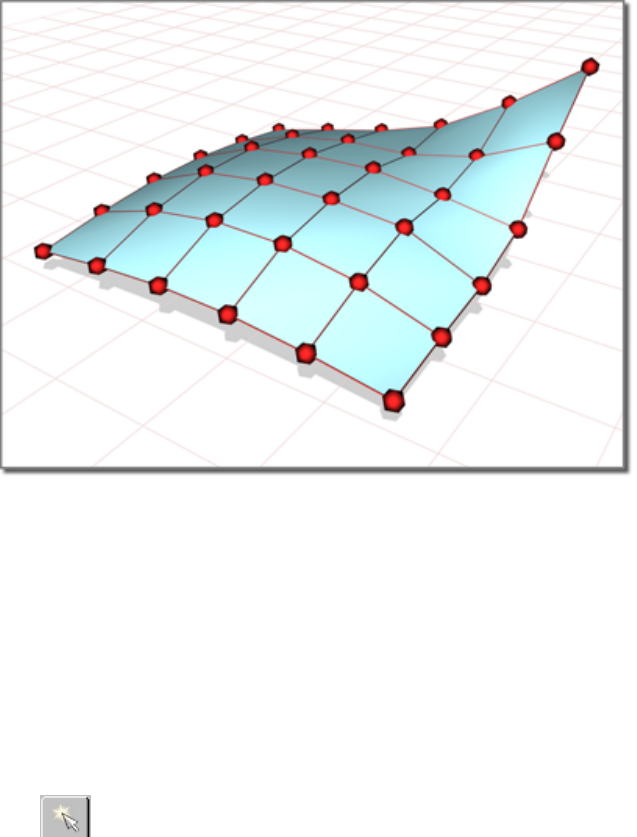
Point Surface
Create panel > Geometry > NURBS Surfaces > Point Surf
Create menu > NURBS > Point Surface
Points shape the surface they lie on.
Point surfaces are NURBS surfaces on page 2190 whose points are constrained
to lie on the surface.
Because an initial NURBS surface is meant to be edited, the surface creation
parameters do not appear on the Modify panel. In this respect, NURBS surface
objects are different from other objects. The Modify panel provides other ways
to change the values you set in the Create panel.
Procedures
To create a point surface:
1 Go to the Create panel.
2192 | Chapter 10 Surface Modeling
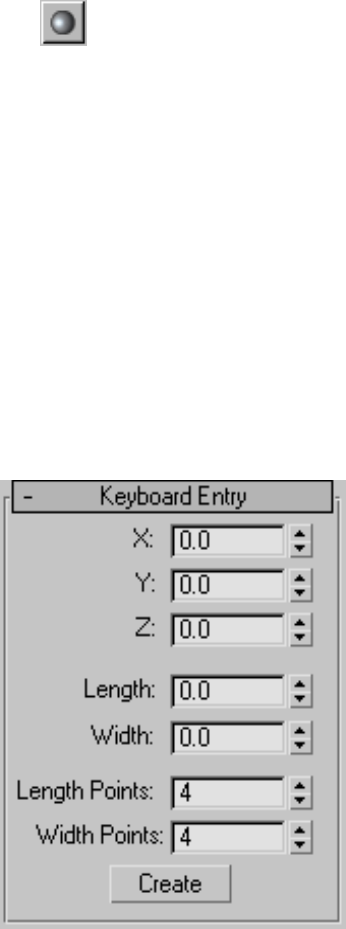
2 Turn on Geometry, and choose NURBS Surfaces from the drop-down
list.
3Turn on Point Surf.
4In a viewport, drag to specify the area of the planar segment.
5Adjust the surface's creation parameters.
Interface
The creation parameters are the same for both point surfaces and CV surfaces,
except that the labels indicate which kind of basic NURBS surface you are
creating.
Keyboard Entry rollout
The Keyboard Entry rollout lets you create a point surface by typing. Use the
Tab key to move between the controls on this rollout. To click the Create
button from the keyboard, press Enter while the button is active.
X, Y, and Z Let you enter the coordinates of the center of the surface.
NURBS Surfaces | 2193
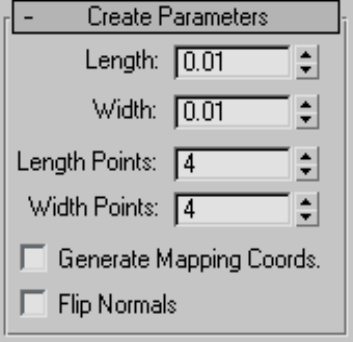
Length and Width Let you enter the dimensions of the surface in current
3ds Max units.
Length Points Lets you enter the number of points along the length of the
surface (this is the initial number of point columns).
Width Points Lets you enter the number of points along the width of the
surface (this is the initial number of point rows).
Create Creates the surface object.
Create Parameters rollout
Length The length of the surface in current 3ds Max units.
Width The width of the surface in current 3ds Max units.
On the Modify panel, the Length and Width spinners are no longer available.
You can change the length or width of the surface by scaling the surface at
the Surface sub-object level. Moving point sub-objects also alters the length
and width of the surface.
Length Points The number of points along the length of the surface. In other
words, the initial number of point columns in the surface. Range=2 to 50.
Default=4.
Width Points The number of points along the width of the surface. In other
words, the initial number of point rows in the surface. Range=2 to 50.
Default=4.
On the Modify panel, the point Length and Width spinners are no longer
available. You can change the number of rows and columns by deleting existing
2194 | Chapter 10 Surface Modeling
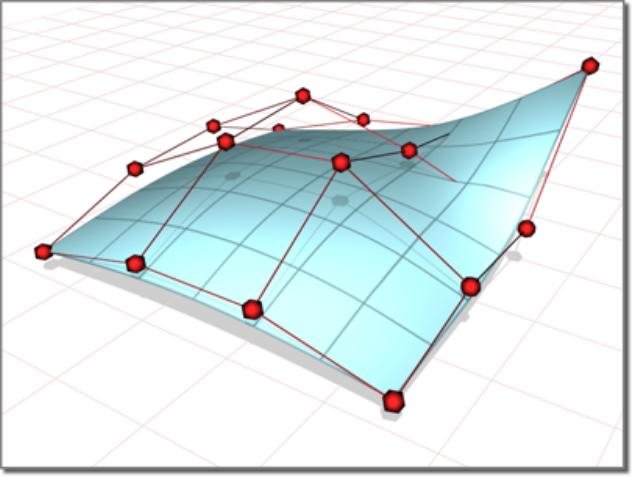
rows and columns, or by adding new rows and columns using the Refine
controls at the Point sub-object level.
Generate Mapping Coordinates Generates mapping coordinates so you can
apply mapped materials to the surface.
The Generate Mapping Coordinates control is present on the Modify panel.
It is at the Surface sub-object level.
Flip Normals Turn on to reverse the direction of the surface normals.
The Flip Normals control is present on the Modify panel. It is at the Surface
sub-object level.
When you modify a point surface, a rollout lets you change its surface
approximation settings on page 2469 .
CV Surface
Create panel > Geometry > NURBS Surfaces > CV Surf
Create menu > NURBS > CV Surface
The CVs in a control lattice shape the surface it defines.
NURBS Surfaces | 2195
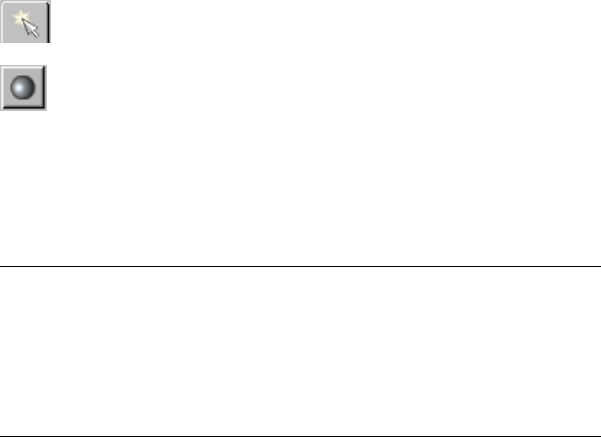
CV surfaces are NURBS surfaces on page 2190 controlled by control vertices (
CVs on page 7750 ). The CVs don't lie on the surface. They define a control
lattice on page 7745 that encloses the surface. Each CV has a weight that you
can adjust to change the shape of the surface.
Because an initial NURBS surface is meant to be edited, the surface creation
parameters do not appear on the Modify panel. In this respect, NURBS surface
objects are different from other objects. The Modify panel provides other ways
to change the values you set in the Create panel.
Procedures
To create a CV surface:
1 Go to the Create panel.
2 Turn on Geometry, and choose NURBS Surfaces from the drop-down
list.
3Turn on CV Surf.
4In a viewport, drag to specify the area of the planar segment.
5Adjust the surface's creation parameters.
NOTE When you edit a CV surface you can add or move CVs so that more
than one CV is at the same location (or close to it) to increase the influence
of the CVs in that region of the surface. Two coincident CVs sharpen the
curvature. Three coincident CVs create an angular peak in the surface. This
technique can help you shape the surface. However, if you later move the
CVs individually, you lose this effect. (You can also obtain the influence of
multiple CVs by fusing on page 7794 CVs.)
Interface
The creation parameters are the same for both point surfaces and CV surfaces,
except that the labels indicate which kind of basic NURBS surface you are
creating.
2196 | Chapter 10 Surface Modeling
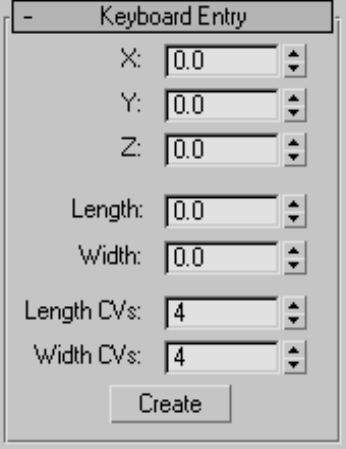
Keyboard Entry rollout
The Keyboard Entry rollout lets you create a CV surface by typing. Use the
Tab key to move between the controls on this rollout. To click the Create
button from the keyboard, press Enter while the button is active.
X, Y, and Z Let you enter the coordinates of the center of the surface.
Length and Width Let you enter the dimensions of the surface, in current
3ds Max units.
Length CVs Lets you enter the number of CVs along the length of the surface
(this is the initial number of CV columns).
Width CVs Lets you enter the number of CVs along the width of the surface
(this is the initial number of CV rows).
Create Creates the surface object.
NURBS Surfaces | 2197
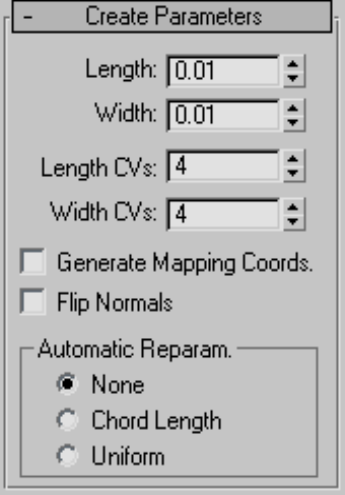
Create Parameters rollout
Length The length of the surface in current 3ds Max units.
Width The width of the surface in current 3ds Max units.
On the Modify panel, the Length and Width spinners are no longer available.
You can change the length or width of the surface by scaling the surface at
the Surface sub-object level. Moving CV sub-objects also alters the length and
width of the surface.
Length CVs The number of CVs along the length of the surface. In other
words, the initial number of CV columns in the surface. Can range from 4 to
50.
Width CVs The number of CVs along the width of the surface. In other
words, the initial number of CV rows in the surface. Can range from 4 to 50.
On the Modify panel, the CV Length and Width spinners are no longer
available. You can change the number of rows and columns by deleting existing
rows and columns, or by adding new rows and columns using the Refine
controls at the Surface CV sub-object level.
2198 | Chapter 10 Surface Modeling
Generate Mapping Coordinates Generates mapping coordinates so you can
apply mapped materials to the surface.
The Generate Mapping Coordinates control is present on the Modify panel.
It is at the Surface sub-object level.
Flip Normals Turn on to reverse the direction of the surface normals.
The Flip Normals control is present on the Modify panel. It is at the Surface
sub-object level.
When you modify a CV surface, a rollout lets you change its surface
approximation settings on page 2469 .
Automatic Reparameterization group
The radio buttons in this group box let you choose automatic
reparameterization. With reparameterization, the surface maintains its
parameterization as you edit it. Without reparameterization, the surface's
parameterization doesn't change as you edit it, and can become irregular.
None Do not reparameterize.
Chord Length Chooses the chord-length algorithm for reparameterization.
Chord-length reparameterization spaces knots (in parameter space on page
7882 ) based on the square root of the length of each curve segment.
Chord-length reparameterization is usually the best choice.
Uniform Spaces the knots uniformly.
A uniform knot vector has the advantage that the surface will change only
locally when you edit it. With the other two forms of parameterization, moving
any CV can change the entire surface.
NURBS Curves
Create panel > Shapes button > NURBS Curves
NURBS on page 7864 curves are Shape objects on page 536 , and you can use
them as you do splines. You can use the Extrude or Lathe modifiers to generate
a 3D surface based on a NURBS curve. You can use NURBS curves as the path
or the shape of a loft. (Lofts created using NURBS curves are loft objects, not
NURBS objects.)
You can also use NURBS curves as Path Constraint and Path Deform paths or
as motion trajectories.
NURBS Curves | 2199
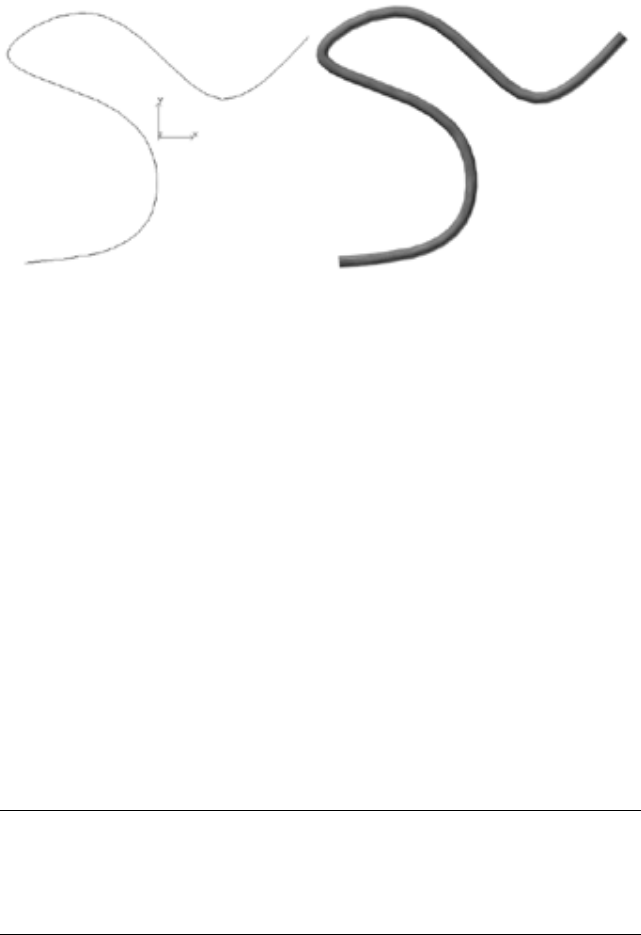
You can assign thickness to a NURBS curve so it renders as a cylindrical object.
(The thickened curve renders as a polygonal mesh, not as a NURBS surface.)
A curve and the same curve rendered with thickness
There are two kinds of NURBS curve objects:
Point Curve on page 2201
CV Curve on page 2208
Like other Shape objects, NURBS curves can contain multiple sub-objects,
which are either dependent or independent.
Creating Curve Sub-Objects on page 2283
Creating Surface Sub-Objects on page 2337
Creating and Editing Point Sub-Objects on page 2428
Common Sub-Object Controls on page 2229
Editing Point Sub-Objects on page 2231
Editing Curve CV Sub-Objects on page 2238
Editing Surface CV Sub-Objects on page 2244
Editing Curve Sub-Objects on page 2252
Editing Surface Sub-Objects on page 2264
NOTE Like an object-level NURBS surface on page 2190 , an object-level NURBS
curve is a top-level NURBS model on page 7865 that can contain NURBS curve,
NURBS surface, and NURBS point sub-objects. A NURBS curve remains a Shape
object unless you add a surface sub-object to it; if you do, it converts to a NURBS
surface (without changing its name).
2200 | Chapter 10 Surface Modeling
Creating Independent Surfaces from NURBS Curve Objects on page 2216
You can also create NURBS curve sub-objects by attaching or importing other
objects such as other NURBS curves or spline shapes.
Attaching and Importing 3ds Max Objects on page 2225
Display Controls for NURBS Models on page 2221
Both NURBS curves and NURBS surfaces have a Display area in the Modify
panel. These controls affect which portions of the NURBS geometry are
displayed. Next to the Display area is the button that turns on the toolbox
for creating sub-objects.
Point Curve
Create panel > Shapes button > NURBS Curves > Point Curve button
Create menu > NURBS > Point Curve
Point curves are NURBS curves on page 2199 whose points are constrained to
lie on the curve.
A point curve can be the basis of a full NURBS model on page 7865 .
NURBS Curves | 2201
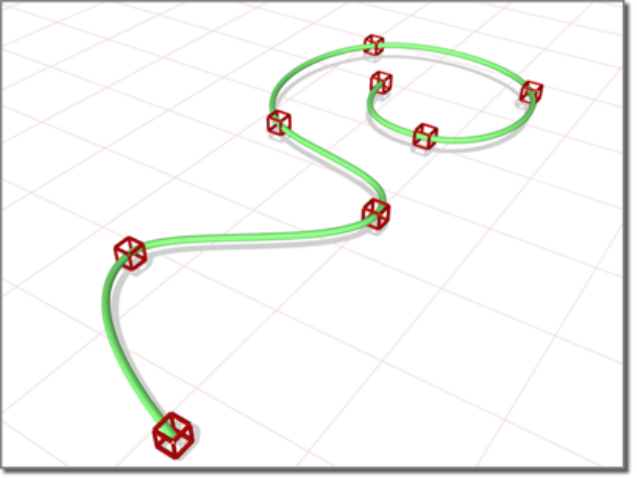
Points lie on the curve they define.
Drawing Three-Dimensional Curves
When you create a point curve, you can draw it in three dimensions. There
are two ways to do this:
■Draw In All Viewports: This toggle lets you use any viewport to draw the
curve, enabling you to draw three dimensionally.
■Using Ctrl to drag points: While you draw a curve, you can use the Ctrl key
to drag a point off of the construction plane.
With the Ctrl–key method, further mouse movement lifts the latest point off
the construction plane. There are two ways to use this:
■Click-drag. If you hold down Ctrl and also hold down the mouse button,
you can drag to change the height of the point. The point's location is set
when you release the mouse button.
This method is probably more intuitive.
2202 | Chapter 10 Surface Modeling
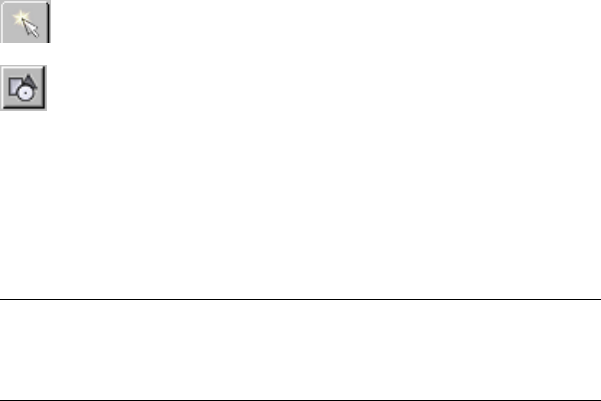
■Click-click. If you Ctrl+click and then release the mouse button, the height
changes as you drag the mouse. Clicking the mouse a second time sets the
point's location.
This method is less prone to repetitive stress injury.
While you are offsetting the point, a red dotted line is drawn between the
original point on the construction plane and the actual point offset from the
plane. You can move the mouse into an inactive viewport, in which case the
software sets the height of the point using the point's Z axis in the inactive
viewport. This lets you set the height of the point with accuracy.
Snaps on page 2578 also work when you change the height of a point. For
example, if you turn on Point snapping, you can set a point to have the same
height as another point by snapping to that other point in an inactive
viewport.
Procedures
To create a NURBS point curve:
1 Go to the Create panel.
2 Turn on Shapes, and choose NURBS Curves from the drop-down
list.
3Turn on Point Curve.
4In a viewport, click and drag to create the first point, as well as the first
curve segment. Release the mouse button to add the second point. Each
subsequent location you click adds a new point to the curve. Right-click
to end curve creation.
NOTE If you begin the curve by clicking without dragging, this also creates
the curve's first point. However, if you release the mouse button more than
five pixels away from where you initially pressed it, this creates an additional
point.
While you are creating a point curve, you can press Backspace to remove
the last point you created, and then previous points in reverse order.
If Draw In All Viewports is on, you can draw in any viewport, creating a
3D curve.
NURBS Curves | 2203
To lift a point off the construction plane, use the Ctrl key as described
earlier in this topic under "Drawing Three-Dimensional Curves."
As with splines, if you click over the curve's initial point, a Close Curve
dialog on page 2462 is displayed. This dialog asks whether you want the
curve to be closed. Click No to keep the curve open or Yes to close the
curve. (You can also close a curve when you edit it at the Curve sub-object
level.) When a closed curve is displayed at the Curve sub-object level, the
initial point is displayed as a green circle, and a green tick mark indicates
the curve's direction.
5Adjust the curve's creation parameters.
6(Optional.) To add a new NURBS curve sub-object, you can turn off the
Start New Shape check box, and then repeat the preceding steps.
Interface
The creation parameters are the same for both point curves and CV curves.
2204 | Chapter 10 Surface Modeling
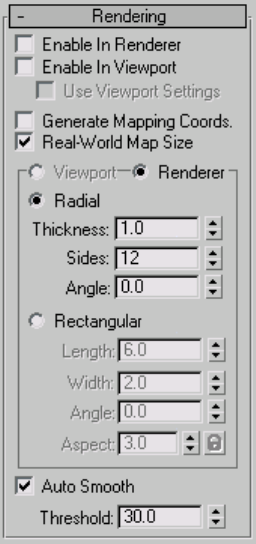
Rendering rollout
Lets you turn on and off the renderability of the curve, specify its thickness
in the rendered scene, and apply mapping coordinates.
Render parameters can be animated. For example, you can animate the number
of sides.
Enable In Renderer When on, the shape is rendered as a 3D mesh using the
Radial or Rectangular parameters set for Renderer. In previous versions of the
program, the Renderable switch performed the same operation.
Enable In Viewport When on, the shape is displayed in the viewport as a
3D mesh using the Radial or Rectangular parameters set for Renderer. In
previous versions of the program, the Display Render Mesh performed the
same operation.
Use Viewport settings Lets you set different rendering parameters, and
displays the mesh generated by the Viewport settings. Available only when
Enable in Viewport is turned on.
NURBS Curves | 2205
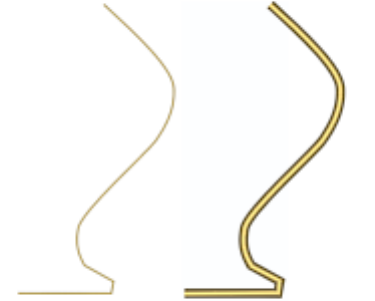
Generate Mapping Coords Turn this on to apply mapping coordinates.
Default=off.
The U coordinate wraps once around the thickness of the spline; the V
coordinate is mapped once along the length of the spline. Tiling is achieved
using the Tiling parameters in the material itself.
Real-World Map Size Controls the scaling method used for texture mapped
materials that are applied to the object. The scaling values are controlled by
the Use Real-World Scale settings found in the applied material's Coordinates
rollout on page 5620 . Default=on.
Viewport Turn this on to specify Radial or Rectangular parameters for the
shape as it will display in the viewport when Enable in Viewport is turned on.
Renderer Turn this on to specify Radial or Rectangular parameters for the
shape as it will display when rendered or viewed in the viewport when Enable
in Viewport is turned on.
Radial Displays the 3D mesh as a cylindrical object.
Thickness Specifies the diameter of the viewport or rendered spline mesh.
Default=1.0. Range=0.0 to 100,000,000.0.
Splines rendered at thickness of 1.0 and 5.0, respectively
Sides Sets the number of sides (or facets) for the spline mesh n the viewport
or renderer. For example, a value of 4 results in a square cross section.
Angle Adjusts the rotational position of the cross-section in the viewport or
renderer. For example, if the spline mesh has a square cross section you can
use Angle to position a "flat" side down.
Rectangular Displays the spline's mesh shape as rectangular.
2206 | Chapter 10 Surface Modeling
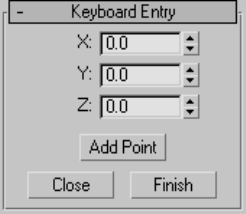
Aspect Sets the aspect ratio for rectangular cross-sections. The Lock check
box lets you lock the aspect ratio. When Lock is turned on, Width is locked
to Depth that results in a constant ratio of Width to Depth.
Length Specifies the size of the cross–section along the local Y axis.
Width Specifies the size of the cross–section along the local X axis.
Angle Adjusts the rotational position of the cross-section in the viewport or
renderer. For example, if you have a square cross-section you can use Angle
to position a "flat" side down.
Auto Smooth If Auto Smooth is turned on, the spline is auto-smoothed using
the threshold specified by the Threshold setting below it. Auto Smooth sets
the smoothing based on the angle between spline segments. Any two adjacent
segments are put in the same smoothing group if the angle between them is
less than the threshold angle.
Threshold Specifies the threshold angle in degrees. Any two adjacent spline
segments are put in the same smoothing group if the angle between them is
less than the threshold angle.
Keyboard Entry rollout
The Keyboard Entry rollout lets you create a NURBS curve by typing. Use the
Tab key to move between the controls in this rollout. To click a button from
the keyboard, press Enter while the button is active.
X, Y, and Z Let you enter the coordinates of the next point to add.
Add Point Adds the point to the curve.
Close Ends creation of the curve and creates a segment between the last
point and the initial point to close the curve.
Finish Ends creation of the curve, leaving it open.
NURBS Curves | 2207
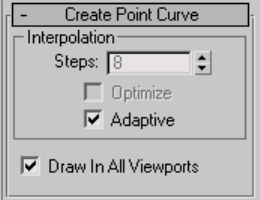
Create Point Curve rollout
This rollout contains the controls for curve approximation.
Interpolation group
The controls in this group box change the accuracy and type of curve
approximation on page 2468 used to generate and display the curve.
Draw In All Viewports Lets you use any viewport while you are drawing the
curve. This is one way to create a 3D curve. When off, you must finish drawing
the curve in the viewport where you began it. Default=on.
While Draw In All Viewports is on, you can also use snaps on page 2578 in any
viewport.
CV Curve
Create panel > Shapes button > NURBS Curves > CV Curve button
Create menu > NURBS > CV Curve
CV curves are NURBS curves on page 2199 controlled by control vertices ( CVs
on page 7750 ). The CVs don't lie on the curve. They define a control lattice on
page 7745 that encloses the curve. Each CV has a weight that you can adjust to
change the curve.
While you're creating a CV curve you can click to create more than one CV
at the same location (or close to it), increasing the influence of the CVs in
that region of the curve. Creating two coincident CVs sharpens the curvature.
Creating three coincident CVs creates an angular corner in the curve. This
technique can help you shape the curve; however, if you later move the CVs
individually, you lose this effect. (You can also obtain the influence of multiple
CVs by fusing on page 7794 CVs.)
2208 | Chapter 10 Surface Modeling
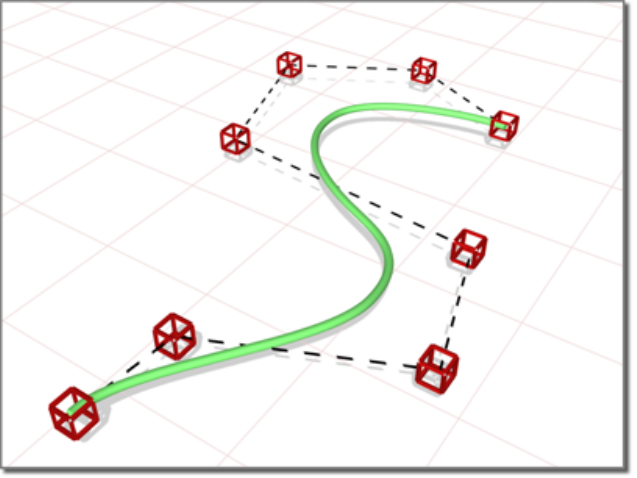
A CV curve can be the basis of a full NURBS model on page 7865 .
CVs shape the control lattice that defines the curve.
Drawing Three-Dimensional Curves
When you create a CV curve, you can draw it in three dimensions. There are
two ways to do this:
■Draw In All Viewports: This toggle lets you use any viewport to draw the
curve, enabling you to draw three dimensionally.
■Using Ctrl to drag CVs: While you draw a curve, you can use the Ctrl key
to drag a CV off of the construction plane.
With the Ctrl–key method, further mouse movement lifts the latest CV off
the construction plane. There are two ways to use this:
■Click-drag. If you hold down Ctrl and also hold down the mouse button,
you can drag to change the height of the CV. The CV's location is set when
you release the mouse button.
This method is probably more intuitive.
NURBS Curves | 2209
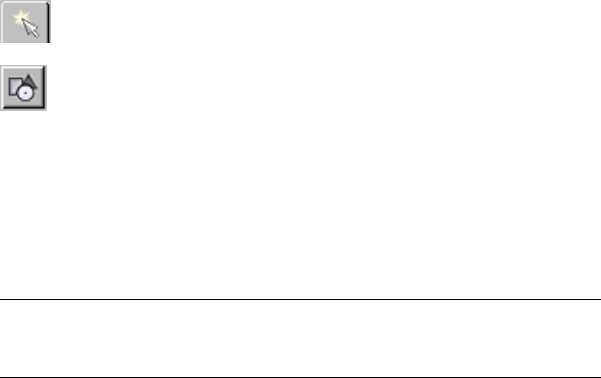
■Click-click. If you Ctrl+click and then release the mouse button, the height
changes as you drag the mouse. Clicking the mouse a second time sets the
CV's location.
This method is less prone to repetitive stress injury.
While you are offsetting the CV, a red dotted line is drawn between the original
CV on the construction plane and the actual CV offset from the plane. You
can move the mouse into an inactive viewport, in which case the software
sets the height of the CV using the CV's Z axis in the inactive viewport. This
lets you set the height of the CV with accuracy.
Snaps on page 2578 also work when you change the height of a CV. For example,
if you turn on CV snapping, you can set a CV to have the same height as
another CV by snapping to that other CV in an inactive viewport.
Procedures
To create a NURBS CV curve:
1 Go to the Create panel.
2 Turn on Shapes, and choose NURBS Curves from the drop-down
list.
3Turn on CV Curve.
4In a viewport, click and drag to create the first CV, as well as the first
curve segment. Release the mouse to add the second CV. Each subsequent
location you click adds a new CV to the curve. Right-click to end curve
creation.
NOTE If you begin the curve by clicking without dragging, this also creates
the curve's first CV. However, if you release the mouse more than five pixels
away from where you initially pressed it, this creates an additional CV.
While you are creating a CV curve, you can press Backspace to remove
the last CV you created, and then previous CVs in reverse order.
If Draw In All Viewports is on, you can draw in any viewport, creating a
3D curve.
To lift a CV off the construction plane, use the Ctrl key as described earlier
in this topic under "Drawing Three-Dimensional Curves."
2210 | Chapter 10 Surface Modeling
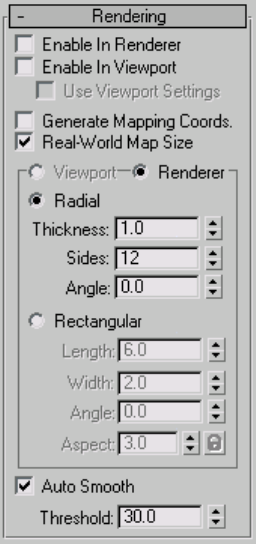
As with splines, if you click over the curve's initial CV, a Close Curve
dialog on page 2448 is displayed. This dialog asks whether you want the
curve to be closed. Click No to keep the curve open or Yes to close the
curve. (You can also close a curve when you edit it at the Curve sub-object
level.) When a closed curve is displayed at the Curve sub-object level, the
initial CV is displayed as a green circle, and a green tick mark indicates
the curve's direction.
5Adjust the curve's creation parameters.
6(Optional) To add a new NURBS curve sub-object, you can turn off the
Start New Shape check box, and then repeat the preceding steps.
Interface
The creation parameters are the same for both point curves and CV curves.
Rendering rollout
NURBS Curves | 2211
Enable In Renderer When on, the shape is rendered as a 3D mesh using the
Radial or Rectangular parameters set for Renderer. In previous versions of the
program, the Renderable switch performed the same operation.
Enable In Viewport When on, the shape is displayed in the viewport as a
3D mesh using the Radial or Rectangular parameters set for Renderer. In
previous versions of the program, the Display Render Mesh performed the
same operation.
Use Viewport settings Lets you set different rendering parameters, and
displays the mesh generated by the Viewport settings. Available only when
Enable in Viewport is turned on.
Generate Mapping Coords Turn this on to apply mapping coordinates.
Default=off.
The U coordinate wraps once around the thickness of the spline; the V
coordinate is mapped once along the length of the spline. Tiling is achieved
using the Tiling parameters in the material itself.
Real-World Map Size Controls the scaling method used for texture mapped
materials that are applied to the object. The scaling values are controlled by
the Use Real-World Scale settings found in the applied material's Coordinates
rollout on page 5620 . Default=on.
Viewport Turn this on to specify Radial or Rectangular parameters for the
shape as it will display in the viewport when Enable in Viewport is turned on.
Renderer Turn this on to specify Radial or Rectangular parameters for the
shape as it will display when rendered or viewed in the viewport when Enable
in Viewport is turned on.
Radial Displays the 3D mesh as a cylindrical object.
Thickness Specifies the diameter of the viewport or rendered spline mesh.
Default=1.0. Range=0.0 to 100,000,000.0.
2212 | Chapter 10 Surface Modeling
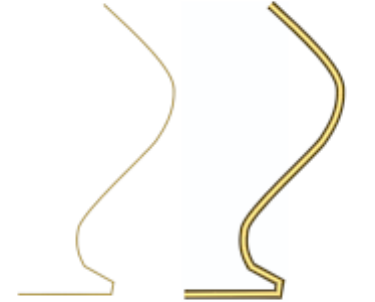
Splines rendered at thickness of 1.0 and 5.0, respectively
Sides Sets the number of sides (or facets) for the spline mesh n the viewport
or renderer. For example, a value of 4 results in a square cross section.
Angle Adjusts the rotational position of the cross-section in the viewport or
renderer. For example, if the spline mesh has a square cross section you can
use Angle to position a "flat" side down.
Rectangular Displays the spline's mesh shape as rectangular.
Aspect Sets the aspect ratio for rectangular cross-sections. The Lock check
box lets you lock the aspect ratio. When Lock is turned on, Width is locked
to Depth that results in a constant ratio of Width to Depth.
Length Specifies the size of the cross–section along the local Y axis.
Width Specifies the size of the cross–section along the local X axis.
Angle Adjusts the rotational position of the cross-section in the viewport or
renderer. For example, if you have a square cross-section you can use Angle
to position a "flat" side down.
Auto Smooth If Auto Smooth is turned on, the spline is auto-smoothed using
the threshold specified by the Threshold setting below it. Auto Smooth sets
the smoothing based on the angle between spline segments. Any two adjacent
segments are put in the same smoothing group if the angle between them is
less than the threshold angle.
Threshold Specifies the threshold angle in degrees. Any two adjacent spline
segments are put in the same smoothing group if the angle between them is
less than the threshold angle.
NURBS Curves | 2213
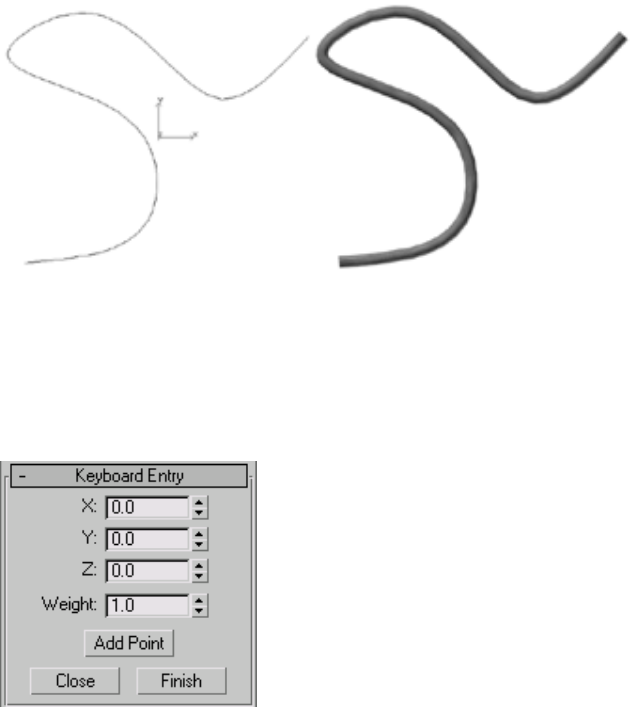
A curve and the same curve rendered with thickness
Keyboard Entry rollout
The Keyboard Entry rollout lets you create a NURBS curve by typing. Use the
Tab key to move between the controls in this rollout. To click a button from
the keyboard, press Enter while the button is active.
X, Y, and Z Let you enter the coordinates of the next CV to add.
Add Point Adds the CV to the curve.
Weight Enter a weight for the CV.
Close Ends creation of the curve and creates a segment between the last CV
and the initial CV, to make the curve a closed curve.
Finish Ends creation of the curve, leaving it open ended.
2214 | Chapter 10 Surface Modeling
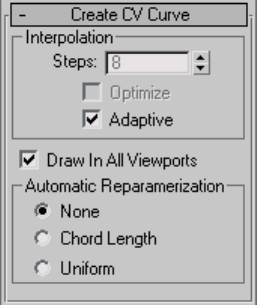
Create CV Curve rollout
This rollout contains the controls for curve approximation.
Interpolation group
The controls in this group box change the accuracy and kind of curve
approximation on page 2468 used to generate and display the curve.
Draw In All Viewports Lets you use any viewport while you are drawing the
curve. This is one way to create a 3D curve. When off, you must finish drawing
the curve in the viewport where you began it. Default=On.
While Draw In All Viewports is on, you can also use snaps on page 2578 in any
viewport.
Automatic Reparameterization group
The controls in this group box let you specify automatic reparameterization.
They are similar to the controls in the Reparameterize dialog on page 2465 ,
with one addition: all choices except for None tell the software to
reparameterize the curve automatically; that is, whenever you edit it by moving
CVs, refining, and so on.
None Do not reparameterize automatically.
Chord Length Chooses the chord-length algorithm for reparameterization.
Chord-length reparameterization spaces knots (in parameter space on page
7882 ) based on the square root of the length of each curve segment.
Chord-length reparameterization is usually the best choice.
NURBS Curves | 2215

Uniform Spaces the knots uniformly.
A uniform knot vector has the advantage that the curve or surface changes
only locally when you edit it. With the other two forms of parameterization,
moving any CV can change the entire sub-object.
Creating NURBS Curve and Surface Objects
Creating Independent Surfaces from NURBS
Curve Objects
To create independent surfaces from top-level NURBS curve objects, use the
Extrude on page 1377 and Lathe on page 1430 modifiers. Extrude adds height
to the curve, creating a shape by sweeping it along the curve's local Z axis.
Lathe creates a surface of rotation, revolving the shape along a specified axis.
You can also use the Bevel on page 1142 and Bevel Profile on page 1150 modifiers
on NURBS curves.
These modifiers treat NURBS curves the same way they treat shapes on page
536 . The advantage of using NURBS curves instead of shapes is in the different
possible shapes that NURBS geometry and editing provide.
TIP When you create a complicated surface, especially with the Lathe modifier,
you often want to render both sides of the surface. Turn on Force 2-Sided in the
Render Scene dialog to see both sides of the extruded or lathed surface. To see
both sides in viewports, turn on Force 2-Sided in the Viewport Configuration
dialog.
By default, an object with Extrude or Lathe collapses to an editable mesh on
page 1990 object. To have Extrude or Lathe output collapse to a NURBS object,
change the setting to NURBS in the Output group box of the Extrude or Lathe
rollout, and then collapse the modifier stack on page 7427 .
Creating NURBS Curves from Splines
Select Spline object. > Modify panel > Right-click the spline name. > Convert
To: NURBS
2216 | Chapter 10 Surface Modeling
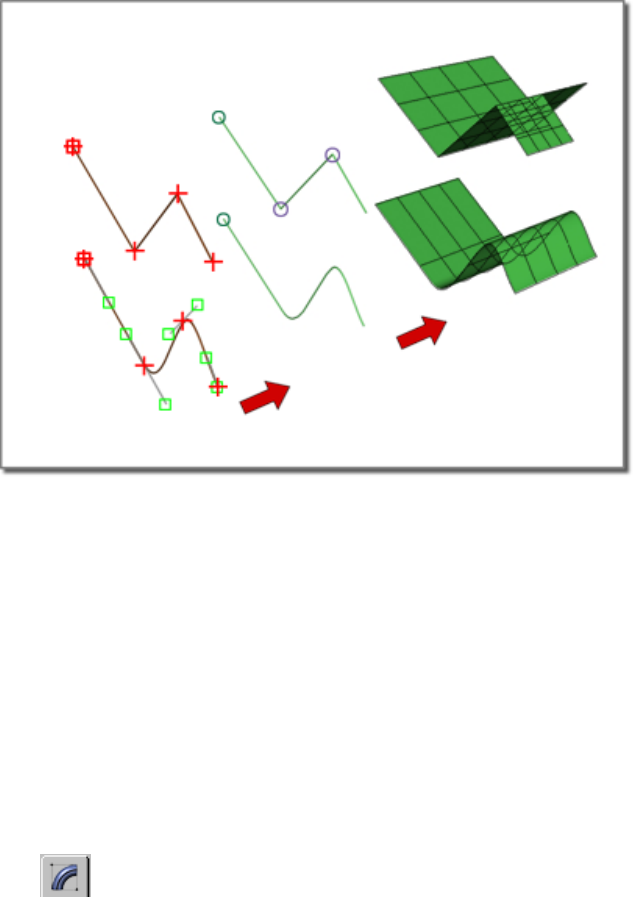
Splines become NURBS curves that then become NURBS surfaces.
You can turn a spline on page 542 into a NURBS object formed of CV curves
on page 2199 . Once converted, you can no longer edit the spline shape
parametrically, but you can edit it as a NURBS object, moving CVs and so on.
When you convert a spline circle on page 557 to a NURBS curve, the direction
of the curve is reversed. This facilitates using the curve to trim a surface: if the
direction weren't reversed, usually the circle would trim outward instead of
inward.
Procedures
To turn a spline into NURBS curves:
1Create the spline.
2 Go to the Modify panel.
3In the stack display, right-click the name of the spline.
4On the pop-up menu, choose Convert To: NURBS.
Creating NURBS Curve and Surface Objects | 2217
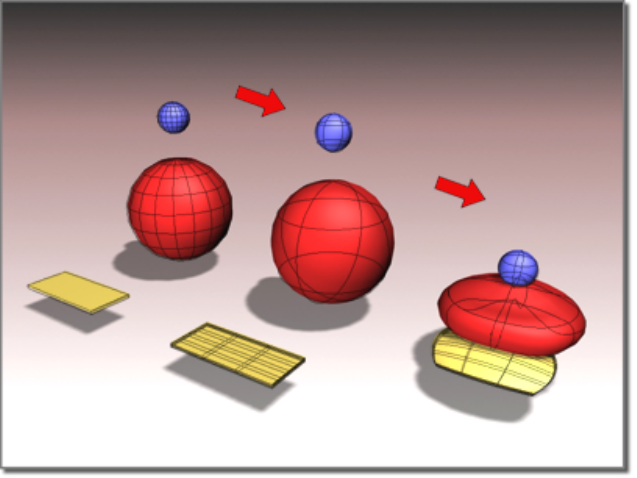
The spline is converted to one or more CV curves.
Smoothly curved splines, such as circles and arcs, convert to a single CV
curve.
Splines with sharp angles, such as rectangles and stars, convert to multiple
CV curves whose endpoints are at the angles in the original spline. These
endpoints are fused except for the initial CV in the spline (for a star, the
initial segment is unfused at both ends).
"Sharp angles" doesn't apply to smooth splines to which you have given
angles by changing vertex tangents using the Edit Spline on page 1376
modifier. These still convert to a single NURBS curve.
Creating NURBS Surfaces from Geometric
Primitives
Primitive objects become NURBS surfaces that you can then edit in various ways.
2218 | Chapter 10 Surface Modeling

You can turn a standard primitive on page 348 into a NURBS object formed
of CV surfaces on page 2340 . Once converted, you can no longer edit the object
parametrically, but you can edit it as a NURBS object, moving CVs and so on.
You can't convert most extended primitive objects in this way, but you can
convert the torus knot on page 389 and prism on page 423 extended primitives
to NURBS objects.
You can also convert patch on page 1982 objects and loft on page 715
compound objects.
Tips
■Geospheres are good for creating rounded models with no sharp edges.
■Boxes are good for creating models that have sharp edges.
■Flattened cones work well for models whose contours are roughly
triangular.
If the primitive is closed, the converted surface is a closed CV surface, which
has no visible seams. Also, relational cap surfaces on page 2377 are used to cap
surfaces that aren't closed.
Procedures
To turn a primitive into a NURBS object:
1Create the primitive object.
2 Go to the Modify panel.
3In the stack display, right-click the name of the object.
4On the pop-up menu, choose Convert To: NURBS.
The object is converted to one or more CV surfaces. The surfaces can be
independent surface sub-objects, or dependent surface sub-objects such
as Lathe.
Nonrelational NURBS Surfaces
Select NURBS object. > Modify panel > General rollout > Relational Stack toggle
Creating NURBS Curve and Surface Objects | 2219
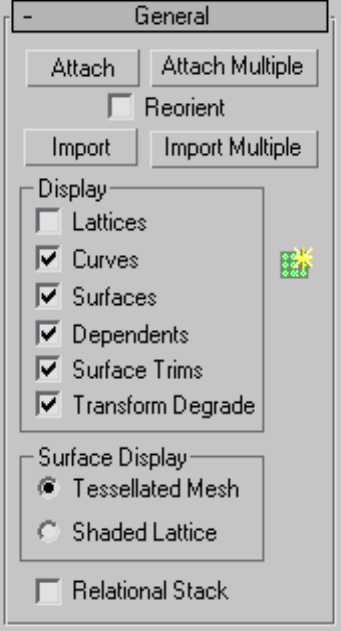
Nonrelational NURBS surfaces provide a way to improve the performance of
NURBS with modifiers. These are controlled by the Relational Stack toggle on
the General rollout for NURBS objects.
When Relational Stack is on, NURBS maintain full relational modeling on the
modifier stack on page 7427 . When this toggle is off (the default), then using
the modifier stack converts surfaces into independent CV surfaces before
applying modifiers. Surfaces on the stack behave in a nonrelational way. If
your NURBS model contains no dependent surfaces, then it behaves the same
on the stack regardless of the Relational Stack setting. However, the results
are still faster if Relational Stack is turned off.
When Relational Stack is off, there is no overhead of copying the data from
the relational model, and no need to compute the relational surfaces, so
performance is faster.
2220 | Chapter 10 Surface Modeling

TIP To improve performance still further, display surfaces as shaded lattices (see
Display Controls for NURBS Models on page 2221 ). With Relational Stack off and
Shaded Lattice chosen, NURBS objects perform on the stack about as well as mesh
objects do.
Procedures
To use nonrelational NURBS surfaces:
1Make sure Relational Stack is off and Shaded Lattice is chosen.
2Set up your modifiers and animation.
3If your model has only independent CV surfaces, you can render it now.
If it has relational surfaces such as blends or lofts, then before you render,
choose the NURBS model at the bottom of the stack, and turn on
Relational Stack.
When you return to the top of the modifier stack, performance is slower
but dependent surfaces are accurate. The modified NURBS model looks
different than it did with the nonrelational stack. Usually the difference
in appearance isn't great, but the nonrelational stack can show anomalies
such as cracks between Blend surfaces.
Display Controls for NURBS Models
Modify panel > Select NURBS object. > General rollout > Display group, Surface
Display group, and NURBS Creation Toolbox button
Modify panel > Select NURBS object. > Right-click in viewport. > Display
commands on the Tools 1 (upper-left) quadrant of the quad menu
The check boxes on the General rollout for a NURBS curve or surface control
how the object is displayed in viewports. If all check boxes are turned off, the
NURBS object is invisible (except for the white bounding-box indicators
displayed in shaded viewports when the object is selected).
An additional rollout, Display Line Parameters on page 2224 , contains controls
for how surfaces display in viewports.
Creating NURBS Curve and Surface Objects | 2221
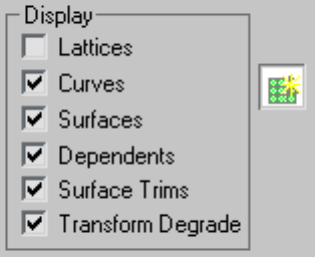
Interface
Display group
Lattices When on, displays control lattices in yellow lines. (You can change
the lattice color using the Colors panel on page 7505 of the Customize User
Interface dialog.) The Curve CV and Surface CV sub-object levels also have a
local Display Lattice toggle, which overrides this global setting at the sub-object
level. The Curve CV and Surface CV settings are independent. In other words,
at the sub-object level you can turn on the lattice for an object’s curves but
not its surfaces, or vice versa.
Keyboard shortcut (while Keyboard Shortcut Override Toggle is on): Ctrl+L
At the object level, this shortcut is equivalent to turning Lattice on or off. At
the sub-object level, Ctrl+L overrides the setting of Lattice, toggling the local
Display Lattice setting.
Curves When on, displays curves.
Keyboard shortcut (while Keyboard Shortcut Override Toggle is on): Ctrl+Shift+C
Surfaces When on, displays surfaces.
Keyboard shortcut (while Keyboard Shortcut Override Toggle is on): Ctrl+Shift+S
Dependents When on, displays dependent sub-objects.
Keyboard shortcut (while Keyboard Shortcut Override Toggle is on): Ctrl+D
Surface Trims When on, displays surface trimming on page 2156 . When
turned off, displays the entire surface, even if it’s trimmed.
Keyboard shortcut (while Keyboard Shortcut Override Toggle is on): Ctrl+Shift+T
2222 | Chapter 10 Surface Modeling
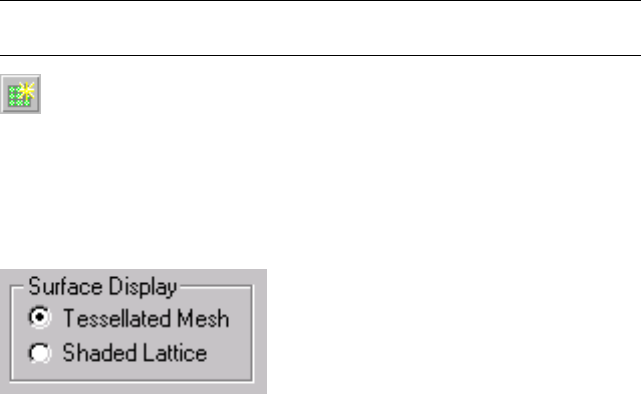
Transform Degrade When on, transforming a NURBS surface can degrade
its display in shaded viewports, to save time. This is similar to the Degradation
Override on page 83 button for playing animations. You can turn off this
toggle so surfaces are always shaded while you transform them, but transforms
can take longer.
Keyboard shortcut (while Keyboard Shortcut Override Toggle is on): Ctrl+X
TIP You can toggle Ctrl+X during a transform, as well as before you begin the
transform.
NURBS Creation Toolbox Turn on to display the NURBS sub-object
creation toolbox. See Using the NURBS Toolbox to Create Sub-Objects on
page 2162 .
Keyboard shortcut (while Keyboard Shortcut Override Toggle is on): Ctrl+T
Surface Display group
This group box, for surfaces only, lets you choose how to display surfaces in
viewports.
Tessellated Mesh When chosen, NURBS surfaces display as fairly accurate
tessellated meshes in shaded viewports. In wireframe viewports, they appear
as either iso curves or wire meshes, depending on the settings you've chosen
on the Display Line Parameters rollout on page 2224 .
Shaded Lattice When chosen, NURBS surfaces appear as shaded lattices in
shaded viewports. Wireframe viewports display the surface's lattice without
shading. A shaded lattice shades the CV control lattice on page 7745 of the
NURBS surface. This displays more quickly than a tessellated mesh. The shading
is not accurate. It gives you a fairly good idea of lofts, but is less accurate for
free-form surfaces. The shading is always as large or larger than the actual
surface, because of the convex hull property on page 7747 .
Shaded lattice display doesn't show surface trimming on page 2156 or texture
mapping.
Creating NURBS Curve and Surface Objects | 2223
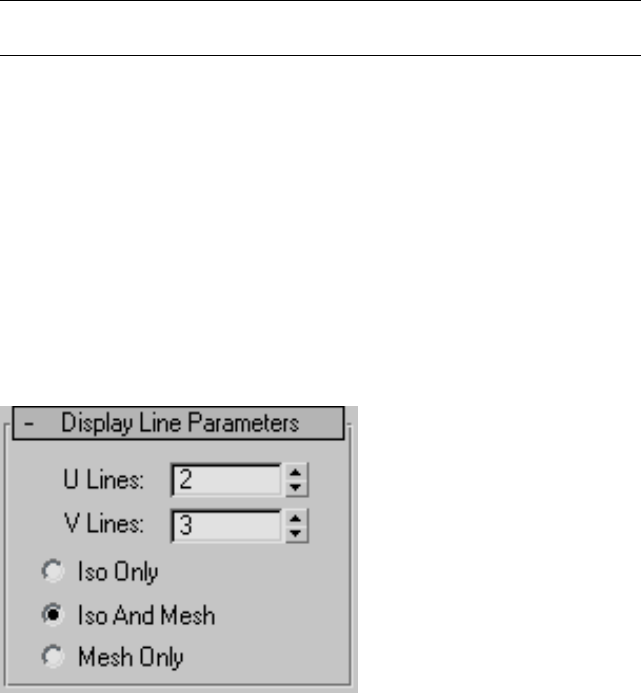
TIP Shaded Lattice is a good option to choose when you use the modifier stack
with nonrelational NURBS surfaces on page 2219 .
Keyboard shortcut: Alt+L
(You can use this keyboard shortcut without having to turn on the Keyboard
Shortcut Override Toggle.)
Display Line Parameters for NURBS Surfaces
Select NURBS object. > Modify panel > Display Line Parameters rollout
These parameters are contained on a single rollout at the top level of a NURBS
object.
Interface
U Lines and V Lines The number of lines used to approximate the NURBS
surface in viewports, along the surface's local U and V dimensions, respectively.
Reducing these values can speed up the display of the surface, but reduce
accuracy of the display. Increasing these values increases accuracy at the
expense of time. Setting one of these values to 0 displays only the edge of the
object in the corresponding dimension.
2224 | Chapter 10 Surface Modeling
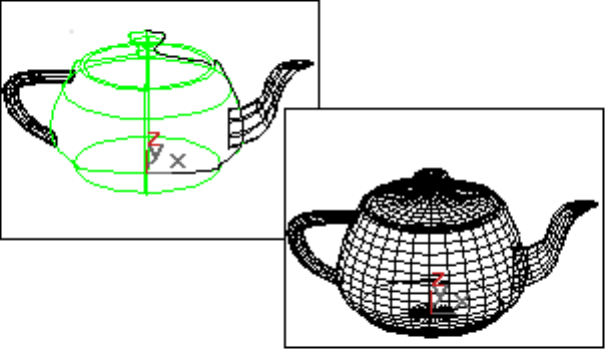
Iso and mesh displays of a NURBS teapot
Iso Only When chosen, all viewports display iso line on page 7822
representations of the surface. Iso(parametric) lines are similar to contour
lines. The lines show where the NURBS surface has a constant U value or V
value or both. Iso line representations can be less crowded and easier to
visualize than wire mesh representations.
Iso and Mesh (The default.) When chosen, wireframe viewports display iso
line representations of the surface, and shaded viewports display the shaded
surface.
Mesh Only When chosen, wireframe viewports display the surface as a wire
mesh, and shaded viewports display the shaded surface. In wireframe viewports,
this option lets you see the surface approximation on page 2469 used for
viewports.
Creating and Editing NURBS Sub-Objects
Attaching and Importing 3ds Max Objects
Modify panel > Select NURBS object. > General rollout > Attach button, Import
button, and related controls
Creating and Editing NURBS Sub-Objects | 2225

There are two ways to bring other 3ds Max objects into a NURBS object:
■Attach, which works like Attach for meshes and splines. It converts the
attached object to NURBS format. Once the object is attached, you can
edit it as a NURBS surface or curve. However, the attached object's history
is lost.
NOTE For NURBS surfaces, you can attach other NURBS objects, standard
primitive on page 348 objects, or quad patch on page 1984 and tri patch on
page 1987 surfaces. The patch is converted to a NURBS surface. Quad patches
convert more successfully than Tri Patches. A converted Tri Patch has a collapsed
internal edge, which gives irregular results when you manipulate its mesh.
When you convert a spline circle on page 557 to a NURBS curve, the
direction of the curve is reversed. This facilitates using the curve to trim a
surface: if the direction weren't reversed, usually the circle would trim
outward instead of inward.
■Import, which works somewhat like the operand of a Boolean on page
686 . The object is brought into the NURBS object without losing its history.
You can select the imported object as a sub-object.
Using Imports
Here are reasons to use Import instead of Attach:
■To maintain parametric control over primitives.
For example, if you import a sphere, you can change its radius directly,
which you can't do after using Attach.
■To use Bezier splines as NURBS curves.
For example, if you want to use a Bezier spline as a curve in a NURBS model,
import it. This allows you to edit it as a Bezier spline, and not as a NURBS
curve.
Surfaces and curves created by an import are available in the NURBS model.
For example, if you import a box, you can create a blend surface between one
of its polygons and another surface in your NURBS object.
Once you have imported an object, the NURBS object has an Imports sub-object
level. When you select an import, it is highlighted in red.
It is an error to apply a modifier to an import when the modifier converts the
import into something that can't be converted to a NURBS object. For example,
if you import a sphere and apply a Bend on page 1139 to it, the sphere converts
2226 | Chapter 10 Surface Modeling
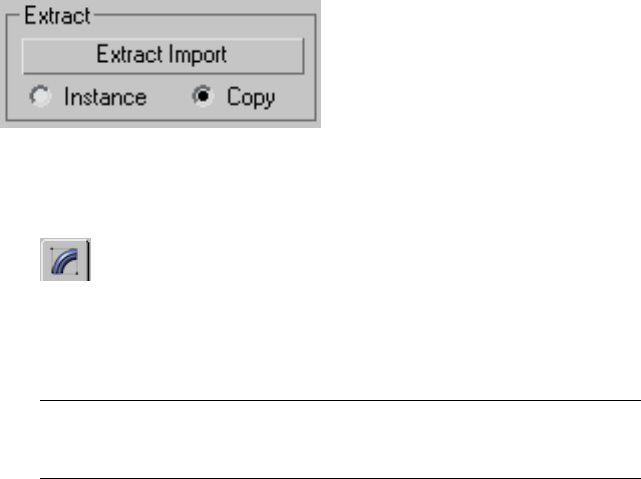
to an editable mesh, which can't automatically convert to a NURBS surface.
In this case, the import sub-object is in an error state, and it is displayed in
the error color (orange by default).
Imports are displayed in two different ways. While you work at the NURBS
object level or at a sub-object level other than Imports, imports are displayed
as NURBS curves or surfaces, and use the NURBS object's mesh tessellation
(see Surface Approximation on page 2469 ). However, at the Imports sub-object
level, the selected import is displayed using its native display format. In other
words, it displays as it would if it were a top-level object. This is because the
display must let you edit the imported object. For example, an imported Bezier
spline needs to display its tangent handles. This wouldn't be possible if it were
displayed as a converted NURBS curve. Leaving the Imports sub-object level
returns to NURBS-style display.
You can extract an imported object. This creates an independent, top-level
object again.
Procedures
To attach or import an object to a NURBS object:
1 Select the NURBS object and go to the Modify panel.
2(Optional.) Turn on Reorient if you want to reorient and align the import
with the center of the NURBS object.
3Turn on Attach or Import.
NOTE At this step, you can click Attach Multiple or Import Multiple instead.
These buttons open a Select From Scene dialog on page 168 so you can
choose multiple objects to attach or import.
4Click the object to attach or import.
The mouse cursor changes shape to indicate a valid object. You can attach
curves, NURBS surfaces, or objects convertible to NURBS.
Creating and Editing NURBS Sub-Objects | 2227
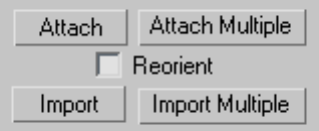
To extract an imported object:
1Go to the Imports sub-object level and select the object to extract.
2Click Extract Import on the Import sub-object rollout.
If Copy is set (the default), the extracted object is a top-level copy of the
imported object. If Instance is set, the extracted object is an instance of
the imported object. Initially the extracted object occupies the same space
as the imported object: you must move either the extracted object, the
import sub-object, or the whole NURBS model before you can see the
extracted object.
Interface
Attach and Import controls
Attach Lets you attach another object to the NURBS object. Click to turn on
Attach, and then click the object to attach. If the object you're attaching isn't
already a NURBS object, it is converted to one or more NURBS curves or surfaces
that are sub-objects of the object you're modifying.
Attach Multiple Lets you attach multiple objects to the NURBS surface. Opens
a version of the Select From Scene dialog on page 168 , listing the objects that
can be attached. Use the dialog controls to select one or more objects by name,
and then click Attach.
Reorient Moves and reorients the object you are attaching or importing so
its creation local coordinate system is aligned with the creation local coordinate
system of the NURBS object.
Import Lets you import another object to the NURBS object. Works the same
way Attach does, but the imported object retains its parameters and modifiers.
Import Multiple Lets you import multiple objects. Works the same way
Attach Multiple does, but the imported objects retain their parameters and
modifiers.
2228 | Chapter 10 Surface Modeling

Common Sub-Object Controls
Many controls are common to the various kinds of sub-objects in NURBS
models (with the exception of Imports on page 2225 ). This topic introduces
the controls that are common to most NURBS sub-objects.
See also:
■Editing Point Sub-Objects on page 2231
■Editing Curve CV Sub-Objects on page 2238
■Editing Surface CV Sub-Objects on page 2244
■Editing Curve Sub-Objects on page 2252
■Editing Surface Sub-Objects on page 2264
Transforming Sub-Objects
One way to alter a NURBS model is to transform its sub-objects. Transforming
lets you interactively change the model’s curvature and shape. Transforming
points or CVs is especially useful for adjusting the shape of a NURBS curve or
surface.
You can also Shift+Clone most kinds of sub-objects, except CVs. For curves
and surfaces, Shift+Cloning displays a Sub-Object Clone Options dialog on
page 2466 , which lets you reduce relational dependencies to improve
performance.
Selection Controls
There is a Selection group box on the rollout for all NURBS sub-objects except
Imports. The buttons in this group let you control which sub-objects to select.
The selection buttons let you select sub-objects individually, or multiple
sub-objects at once. For example, Surface CV selection buttons give you the
option of selecting individual CVs, or selecting a row of CVs on the surface,
and so on.
NOTE There is no delete modifier for NURBS curves as there is for splines. There
is a NURBS selection modifier, NSurf Sel on page 1513 . See NURBS and Modifiers
on page 2172 .
Creating and Editing NURBS Sub-Objects | 2229

Selection controls also include a Name field that lets you customize the name
of individual NURBS sub-objects other than CVs. (The Name field is the only
selection control for Import sub-objects.)
Visibility
You can hide or unhide NURBS sub-objects as you do other objects. Hidden
sub-objects are invisible in viewports, but remain renderable. (At the sub-object
level, hiding doesn’t affect the renderer.) You can’t select hidden sub-objects.
Hide and unhide by name is available for curve and surface sub-objects.
Make Independent
You can make a dependent point, curve, or surface sub-object independent.
WARNING When you make an object independent, you lose the animation
controllers for all objects that depend on it in turn. When you make point objects
independent, you lose the animation controllers for all points on the curve or
surface. Also, if you make a curve that trims a surface independent, you lose the
trimming of the surface.
Remove Animation
All sub-object rollouts have a Remove Animation button. This removes
animation controllers from the selected sub-objects.
Detach and Copy
You can create a new curve or surface object by detaching a curve or surface
sub-object from a NURBS model. To do so, select the curve or surface and then
click Detach. A dialog is displayed, which lets you enter a name for the new
NURBS object. The new object is no longer part of the original NURBS object.
You can also use the Detach button to create a new NURBS object that is a
copy of a curve or surface sub-object. To do so, select the curve or surface, and
click to turn on Copy before you click Detach. A dialog is displayed, which
lets you enter a name for the new object. The original curve or surface
sub-object remains part of the NURBS object you were editing, but the copied
curve or surface is now a NURBS object of its own.
Relational This toggle affects dependent objects. When off, detaching a
dependent sub-object makes it an independent object. For example, detaching
a U loft converts it to a CV surface. When on, detaching a dependent sub-object
2230 | Chapter 10 Surface Modeling

also detaches the objects it depends on, so the object remains dependent. For
example, detaching a U loft also detaches the curves that define it.
Editing Point Sub-Objects
Modify panel > Select NURBS object or sub-object. > Point sub-object level >
Select point sub-objects.
Modify panel > Select NURBS object or sub-object. > Right-click. > Tools 1
(upper-left) quadrant > Sub-objects > Point > Select point sub-objects.
This topic describes the controls for point sub-objects. A rollout labeled Point
contains the point sub-object controls for NURBS models. In addition to the
Point rollout described here, the Point sub-object level displays the Soft
Selection rollout on page 2275 .
Procedures
To transform point sub-objects:
1At the Point sub-object level, select one or more points.
The sub-object selection tools are the same as for other kinds of
sub-objects. You can also use the H key while the Keyboard Shortcut
Override toggle on page 7646 is on. See Sub-Object Selection on page 2164
.
The Selection group box, described under "Interface" later in this topic,
provides some additional options for selecting Point sub-objects.
2Turn on Move or another transform and then drag in a viewport to
transform the selection.
The shape of the model changes as you interactively transform the points.
Rotate and Scale are useful only when you've selected multiple points.
Tips
■ The Lock Selection Set button is useful when you transform NURBS
point sub-objects. You can make a selection in one viewport, click Lock
Selection Set (or press the Spacebar), and then transform the selection in
a different viewport.
Creating and Editing NURBS Sub-Objects | 2231

■When you move point sub-objects, move them as systematically as possible
to avoid "getting lost."
■On surfaces, avoid moving points so they cross over or under adjacent
points. This can create odd-looking warps or overlaps in the surface.
To Shift+Clone a point sub-object:
■Hold down Shift while you transform the point.
This works only for points that lie on curves or surfaces, independent
point on page 2429 sub-objects, and curve point on page 2432 or surface
point on page 2435 sub-objects that lie on the curve or surface (that is, that
aren't displaced).
To use the keyboard to select point sub-objects:
You can select point sub-objects using the Ctrl key and the arrow keys. The
arrows traverse the sub-objects in the order they were created. To do so, follow
these steps:
1 Turn on the Keyboard Shortcut Override Toggle.
2Click or drag to select points.
3Hold down Ctrl and use the arrow keys to move among the point
sub-objects.
For points on curves, the arrow keys traverse the point selection along
the length of the curve. The arrow keys don’t move between curve
sub-objects.
For points on surfaces, the left and right arrow keys traverse the U
dimension of a surface, while the up and down arrow keys traverse the
V dimension of the surface. The arrow keys don’t move between surface
sub-objects.
The arrow keys don’t traverse individually created points that aren’t part
of a curve or surface.
You can also use the H keyboard shortcut (while the Keyboard Shortcut
Override Toggle is on) to display a dialog and select points by name. Ctrl+H
displays only the names of points directly beneath the mouse cursor.
2232 | Chapter 10 Surface Modeling

To remove a point from a curve:
1Select a point.
2In the Delete group box, click Point.
Keyboard shortcut: Delete
The point is deleted and the shape of the curve is updated.
NOTE An open point curve must have at least two endpoints.
To remove points from a surface:
1Select a point, row, or column.
The appropriate Delete buttons are enabled.
2In the Delete group box, click Point, Row, or Col.
The point, row, or column is deleted. Deleting a "single" point actually
deletes both the row and column to which the point belongs.
To add a point to a curve:
1In the Refine group box, turn on Curve.
2Click the curve where you want to add the point.
A point is added at the location you clicked. The curvature can change.
To add a point and extend the length of a curve:
1Click to turn on Extend.
2Move the mouse over a point curve. The curve is highlighted in blue,
and one of the curve's ends displays a box to show where the curve will
be extended.
3Drag from the highlighted end point, and then release the mouse button.
A new point is added beyond the original length of the curve.
To add points to a point surface:
1In the Refine group box, click Surf Row, Surf Col., or Surf Row & Col.
2Click the surface.
Creating and Editing NURBS Sub-Objects | 2233

A row, a column, or both are added close to the point where you clicked
the surface. The new points are placed on the surface so they preserve
the surface’s curvature. The curvature can change, but only slightly.
To fuse two points:
1Turn on Fuse.
2Click a point without releasing the mouse button. Drag to another point,
and then release the mouse button.
The first point you choose acquires the position of the second point, and
becomes dependent to it. If the first point has an animation controller,
the controller is discarded. If the second point has an animation
controller, the first point acquires it too.
Fused points display in purple by default.
To unfuse fused points:
1Select the fused point.
2Click Unfuse.
Now you can move and edit the two points independently.
To transform a region:
1Using sub-object selection, select one or more points for the center of
transformation.
2Turn on Soft Selection.
3Transform the point.
A region around the selected point is transformed accordingly.
Move is the most common transform to use. Rotate and Scale can be used
with a non-local transform center.
TIP If Soft Selection appears not to be working, the Falloff value might be too
small for the size of your surface. On the Soft Selection rollout on page 2275 ,
increase the value of Falloff so it encompasses other points.
2234 | Chapter 10 Surface Modeling
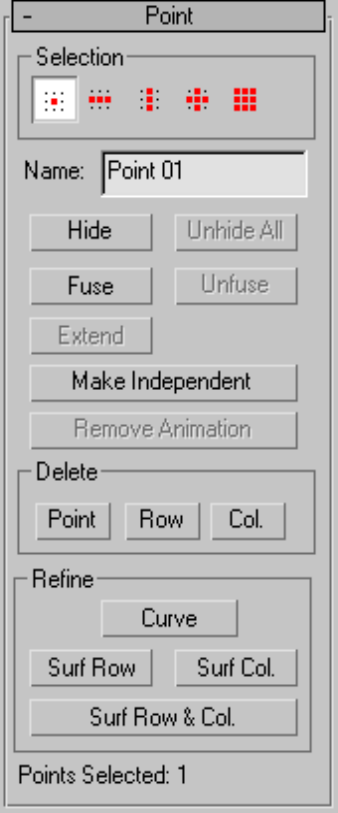
Interface
In addition to the Point rollout described here, the Point sub-object level also
displays the Soft Selection rollout on page 2275 .
Creating and Editing NURBS Sub-Objects | 2235
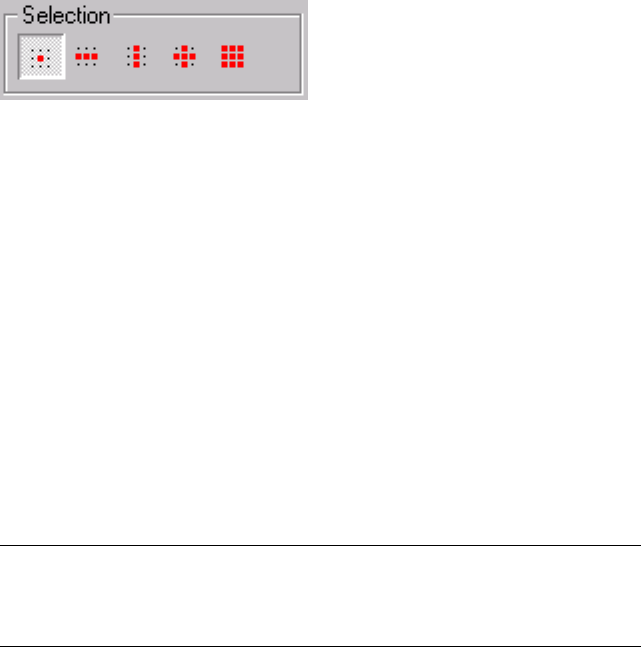
Selection group
Point sub-object selection controls
Single Point (The default.) When on, you can select individual points by
clicking, or groups of points by dragging a region.
Row of Points When on, clicking a point selects the entire row the point
belongs to. Dragging selects all rows in the region.
If the point is on a curve, Row of Points selects all points in the curve.
Column of Points When on, clicking a point selects the entire column the
point belongs to. Dragging selects all columns in the region.
If the point is on a curve, Column of Points selects only a single point.
Row and Column of Points When on, clicking a point selects both the row
and column the point belongs to. Dragging selects all rows and columns in
the region.
All Points When on, clicking or dragging selects all the points in the curve
or surface.
TIP Rows and columns are easily visible when the NURBS surface is planar, or
nearly so. When the surface has a complicated curvature, rows and columns can
be more difficult to see. The Row, Column, and Row/Column buttons can be
especially useful in this situation.
Name Shows the name of the currently selected point. It is disabled if you
have selected multiple points.
By default, the name is "Point" followed by a sequence number. You can use
this field to give the point a name that you choose.
Hide Click to hide the currently selected points.
Unhide All Click to unhide all hidden points.
Fuse Fuses a point to another point. (You can't fuse a CV to a point, or vice
versa.) This is one way to connect two curves or surfaces. It is also a way to
change the shape of curves and surfaces.
2236 | Chapter 10 Surface Modeling
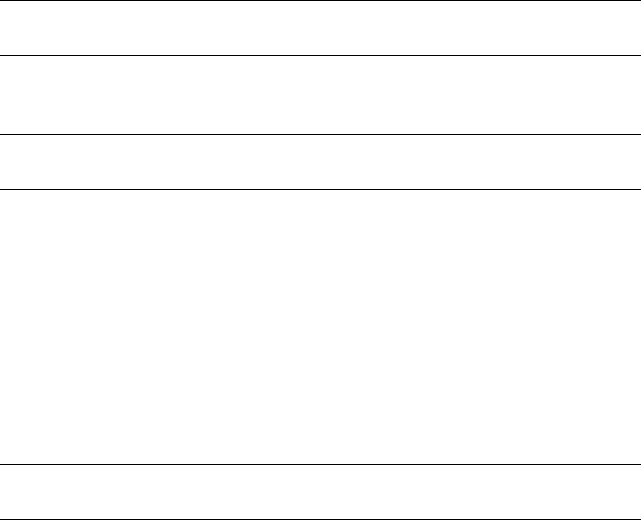
Fusing points does not combine the two point sub-objects. They are connected
but remain distinct sub-objects that you can unfuse later.
Fused points behave as a single point until you unfuse them.
Fused points are displayed in a distinct color. The default is purple. (You can
change this color using the Colors panel on page 7505 of the Customize User
Interface dialog on page 7489 .)
Unfuse Unfuses the fused points.
Extend Extends a point curve. Drag from the end of a curve to add a new
point and extend the curve.
WARNING When you add points with Extend, you lose the animation controllers
for all points on the curve or surface.
Make Independent Disabled if the point is independent. If the point is
dependent, clicking this button makes it independent.
WARNING When you make a point independent, you lose the animation
controllers for all objects that depend on it in turn.
Remove Animation Removes animation controllers from the selected points.
Delete group
The buttons in this group box delete one or more points.
Point Deletes a single point (on a curve) or a row and column of points (on
a surface).
Row Deletes a row from a surface.
Col. Deletes a column from a surface.
WARNING When you delete points, you lose the animation controllers for all
points on the curve or surface.
Refine group
The buttons in this box refine point curves or surfaces by adding points to
them.
Curve Adds points to a point curve.
Surf Row Adds a row of points to a point surface.
Creating and Editing NURBS Sub-Objects | 2237

Surf Col. Adds a column of points to a point surface.
Surf Row & Col. Adds both a row and a column to a point surface; their
intersection is where you click the surface.
WARNING When you add points, you lose the animation controllers for all points
on the curve or surface.
Points Selected This text field shows how many points are currently selected.
Editing Curve CV Sub-Objects
Modify panel > Select NURBS object or sub-object. > Stack display > Curve CV
sub-object level > Select CV sub-objects.
Modify panel > Select NURBS object or sub-object. > Right-click. > Tools 1
(upper-left) quadrant > Sub-objects > Curve CV > Select CV sub-objects.
This topic describes the controls for CV sub-objects that lie on curves. A rollout
labeled CV contains the CV sub-object controls for NURBS models. In addition
to the CV rollout described here, the Curve CV sub-object level displays the
Soft Selection rollout on page 2275 .
In you can edit the CVs in CV curves on surfaces on page 2327 as you edit
other kinds of curve CVs. You can transform CVs in CV curves on surfaces,
but you can't move the CVs off the surface. Using the Curve CV sub-object
level is an alternative to editing these CVs by using the Edit Curve on Surface
on page 2450 dialog.
Procedures
To transform curve CV sub-objects:
1At the Curve CV sub-object level, select one or more CVs.
The sub-object selection tools are the same as for other kinds of
sub-objects. You can also use the H key while the Keyboard Shortcut
Override toggle on page 7646 is on. See Sub-Object Selection on page 2164
.
The Selection group box, described under "Interface" later in this topic,
provides some additional options for selecting CV sub-objects.
2Turn on Move or another transform and then drag in a viewport to
transform the selection.
The shape of the model changes as you interactively transform the CVs.
2238 | Chapter 10 Surface Modeling
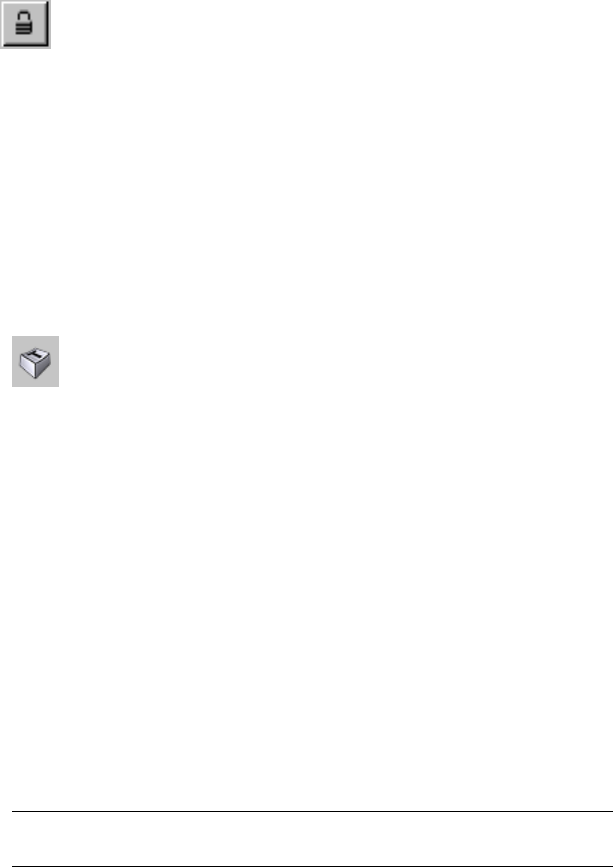
Rotate and Scale are useful only when you've selected multiple CVs.
Tips
■ When you transform NURBS CV sub-objects, the Lock Selection Set
button can be useful. You can make a selection in one viewport, click Lock
Selection Set (or press the Spacebar), and then transform the selection in
a different viewport.
■When you move CV sub-objects, move them as systematically as possible
to avoid "getting lost."
To use the keyboard to select curve CV sub-objects:
You can select curve CV sub-objects using the Ctrl key and the arrow keys.
The arrows traverse the sub-objects in the order they were created. To do so,
follow these steps:
1 Turn on the Keyboard Shortcut Override Toggle.
2Click or drag to select CVs.
3Hold down Ctrl and use the arrow keys to move among the CV sub-objects.
For CVs on curves, the arrow keys traverse the CV selection along the
length of the curve. The arrow keys don’t move between curve sub-objects.
You can also use the H keyboard shortcut (while the Keyboard Shortcut
Override Toggle button is on) to display a dialog and select CVs by name.
Ctrl+H displays only the names of CVs directly beneath the mouse cursor.
To remove a CV from a curve:
1Select a CV.
2Click Delete.
Keyboard shortcut: Delete
The CV is deleted and the shape of the curve is updated.
NOTE A CV curve must have at least one more CV than the degree on page
7755 of the curve.
Creating and Editing NURBS Sub-Objects | 2239
To add a CV to a curve:
1Turn on Refine.
2Click the curve where you want to add the CV.
A CV is added at the location you clicked. Neighboring CVs move away
from the new CV in order to preserve the original curvature.
To add CVs and extend the length of a curve:
1Click to turn on Extend.
2Move the mouse over a CV curve. The curve is highlighted in blue, and
one of the curve's ends displays a box to show where the curve will be
extended.
3Drag from the highlighted end CV, and then release the mouse button.
New CVs are added beyond the original length of the curve.
To fuse two CVs:
1Turn on Fuse.
2Click a CV without releasing the mouse button. Drag to another CV, and
then release the mouse button.
The first CV you choose acquires the position of the second CV, and
becomes dependent to it. If the first CV has an animation controller, the
controller is discarded. If the second CV has an animation controller, the
first CV acquires it too.
Fused CVs display in purple by default.
To unfuse fused CVs:
1Select the fused CV.
2Click Unfuse.
Now you can move and edit the two CVs independently.
To transform a region:
1Using sub-object selection, select one or more CVs for the center of
transformation.
2Turn on Soft Selection.
2240 | Chapter 10 Surface Modeling
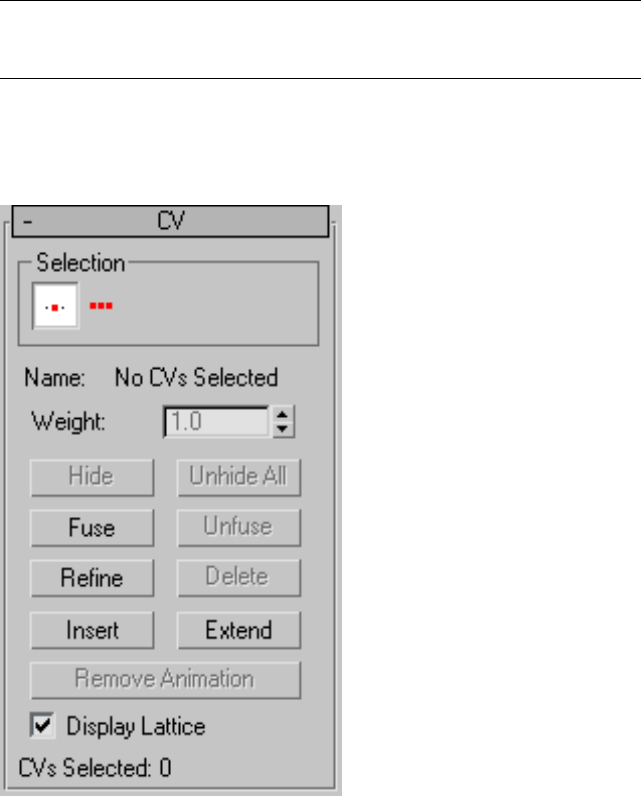
3Transform the CV.
A region around the selected CV is transformed accordingly.
Move is the most common transform to use. Rotate and Scale can be used
with a non-local transform center.
TIP If Soft Selection appears not to be working, the Falloff value might be too
small for the size of your surface. On the Soft Selection rollout on page 2275 ,
increase the value of Falloff so it encompasses other points or CVs.
Interface
In addition to the CV rollout described here, the Curve CV sub-object level
also displays the Soft Selection rollout on page 2275 .
Creating and Editing NURBS Sub-Objects | 2241
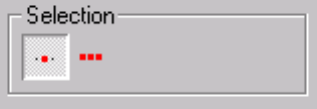
Selection group
Curve sub-object selection controls
Single CV (The default.) When on, you can select individual CVs by clicking,
or groups of CVs by dragging a region.
All CVs When on, clicking or dragging selects all the CVs in the curve.
Name Shows either "No CVs selected", "Multiple CVs selected", or
"CurveName(index)", where "CurveName" is the name of the CV's parent
curve, and "index" is the CV's U location along the length of the curve. You
can't edit the Name field to customize the names of CVs.
If CVs are fused, the Name field shows the name of the first CV.
Weight Adjusts the weight of the selected CVs. You can use a CV's weight to
adjust the CV's effect on the curve. Increasing the weight pulls the curve
toward the CV. Decreasing the weight relaxes the curve away from the CV.
Increasing weight is a way to harden a curve; that is, to sharpen its curvature
at a particular location.
By default, the weight is 1.0 for the CVs of NURBS objects that you create on
the Create panel or the NURBS sub-object creation rollouts. The weight of
CVs in geometry that you convert to NURBS can vary, depending on the
object's original shape.
You can change the weight when multiple CVs are selected. Using the Weight
field or spinner while multiple CVs are selected assigns all of them the value
you choose. Because weights are relative to each other (rational), using the
Weight control when all CVs are selected has no visible effect.
Hide Click to hide the currently selected CVs.
Unhide All Click to unhide all hidden CVs.
Fuse Fuses a CV to another CV. (You can't fuse a CV to a point, or vice versa.)
This is one way to connect two curves. It is also a way to change the shape of
curves.
Fusing CVs does not combine the two CV sub-objects. They are connected but
remain distinct sub-objects that you can unfuse later.
2242 | Chapter 10 Surface Modeling
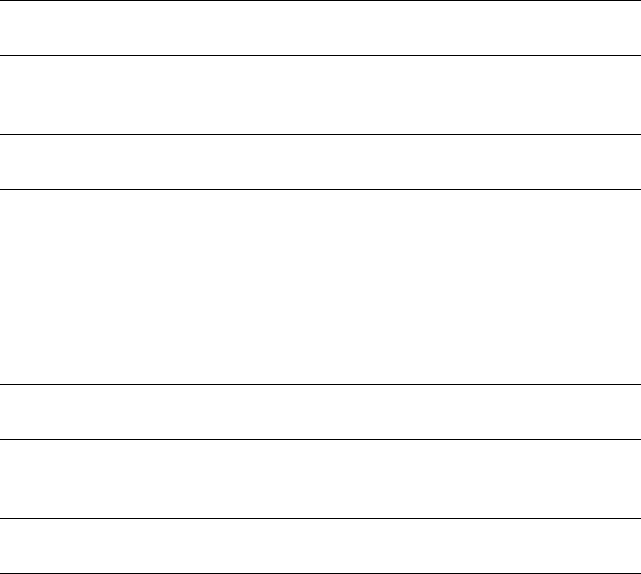
Fused CVs behave as a single CV until you unfuse them. Fused CVs behave
similar to a single point, but the property of multiplicity for coincident CVs
also applies. (See NURBS Concepts on page 2176 and CV Curve on page 2208 .)
The fused CVs have proportionally more influence on the curve. The curve
can become sharper in the fused CVs' vicinity, or even angular if more than
two CVs are fused together.
Fused CVs are displayed in a distinct color. The default is purple. (You can
change this color using the Colors panel on page 7505 of the Customize User
Interface dialog on page 7489 .)
Unfuse Unfuses the fused CVs.
Refine Refines the curve by adding CVs.
WARNING When you add CVs with Refine, you lose the animation controllers for
all CVs on the curve.
As you move the mouse over the CV curve, a preview of the CVs that will be
added, and their locations, is displayed in blue.
TIP It is a good idea to reparameterize after you have added CVs to a curve by
refining. See Editing Curve Sub-Objects on page 2252 .
Delete Deletes the selected CVs.
Insert Inserts CVs into the curve. Click Insert and then click the curve where
you want to insert the new CV. Inserting CVs is similar to refining with CVs,
except that other CVs in the curve do not move. This means that the shape
of the curve changes when you insert.
Inserting CVs does not remove animation from the curve, as refining does.
TIP It is a good idea to reparameterize after you have added CVs to a curve by
inserting. See Editing Curve Sub-Objects on page 2252 .
Extend Extends a CV curve. Drag from the end of a curve to add a new CV
and extend the curve.
WARNING When you add points with Extend, you lose the animation controllers
for all points on the curve.
Remove Animation Removes animation controllers from the selected CVs.
Display Lattice When on, displays the control lattice on page 7745 that
surrounds CV curves. When off, the control lattice isn't shown in viewports.
Default=on.
Creating and Editing NURBS Sub-Objects | 2243
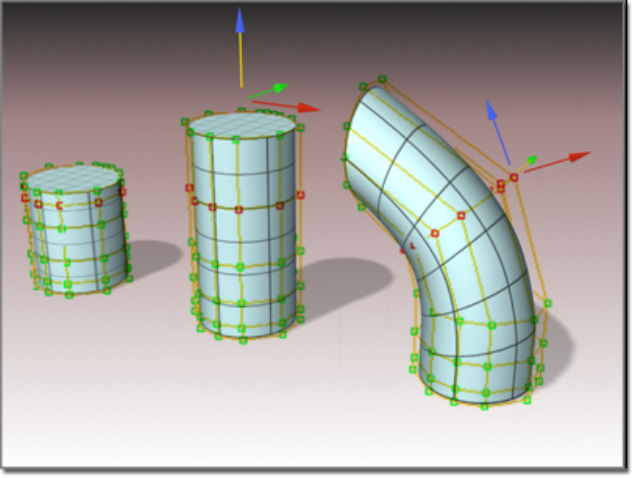
CVs Selected This text field shows how many CVs are currently selected.
Editing Surface CV Sub-Objects
Modify panel > Select NURBS object or sub-object. > Stack display > Surface
CV sub-object level > Select CV sub-objects.
Modify panel > Select NURBS object or sub-object. > Right-click a viewport. >
Tools 1 (upper-left) quadrant > Sub-objects > Surface CV > Select CV
sub-objects.
Transforming CVs changes the shape of the surface.
Procedures on page 2245
Interface on page 2247
This topic describes the controls for CV sub-objects that lie on surfaces. A
rollout labeled CV contains the CV sub-object controls for NURBS models. In
addition to the CV rollout described here, the Curve CV sub-object level
displays the Soft Selection rollout on page 2275 .
2244 | Chapter 10 Surface Modeling

Procedures
To transform surface CV sub-objects:
1At the Surface CV sub-object level, select one or more CVs.
The sub-object selection tools are the same as for other kinds of
sub-objects. You can also use the H key while the Keyboard Shortcut
Override Toggle on page 7646 button is on. See Sub-Object Selection on
page 2164 .
The Selection group box, described under "Interface" later in this topic,
provides additional options for selecting CV sub-objects.
2Turn on Move or another transform and then drag in a viewport to
transform the selection.
The shape of the model changes as you interactively transform the CVs.
Rotate and Scale are useful only when you've selected multiple CVs.
Tips
■ The Lock Selection Set button is useful when you transform NURBS
CV sub-objects. You can make a selection in one viewport, click Lock
Selection Set (or press the Spacebar), and then transform the selection in
a different viewport.
■When you move CV sub-objects, move them as systematically as possible
to avoid "getting lost."
■On surfaces, avoid moving CVs so they cross over or under adjacent points.
This can create odd-looking warps or overlaps in the surface.
To Shift+clone surface sub-objects:
■Hold down Shift while you transform the surface selection.
The Sub-Object Clone Options on page 2466 dialog appears. This dialog
provides various ways to clone the surfaces, some of which reduce relational
dependencies to improve performance.
Creating and Editing NURBS Sub-Objects | 2245
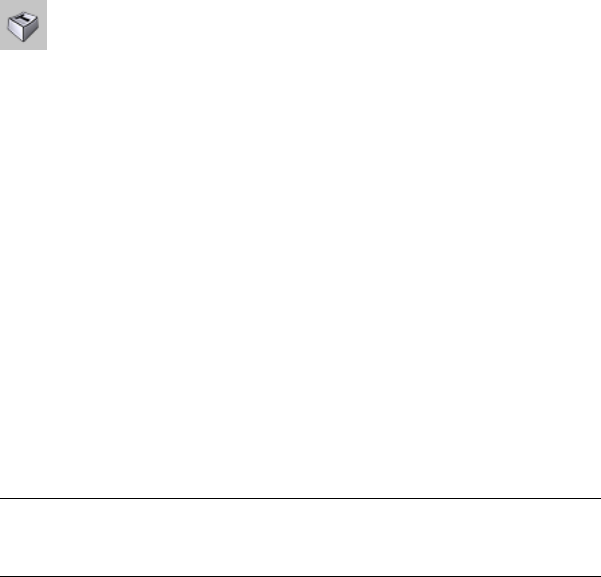
To use the keyboard to select surface CV sub-objects:
You can select surface CV sub-objects using the Ctrl key and the arrow keys.
The arrows traverse the sub-objects in the order they were created. To do so,
follow these steps:
1 Turn on the Keyboard Shortcut Override Toggle.
2Click or drag to select CVs.
3Hold down Ctrl and use the arrow keys to move among the CV sub-objects.
For CVs on surfaces, the left and right arrow keys traverse the U dimension
of a surface, while the up and down arrow keys traverse the V dimension
of the surface. The arrow keys don’t move between surface sub-objects.
You can also use the H keyboard shortcut (while the Keyboard Shortcut
Override Toggle button is on) to display a dialog and select CVs by name.
Ctrl+H displays only the names of CVs directly beneath the mouse cursor.
To remove CVs from a surface:
1Select a row, column, or a row and column.
The appropriate Delete buttons are enabled.
2In the Delete group box, click Row, Col., or Both.
The row, the column, or both are deleted.
NOTE You can't delete a single CV from a CV surface. Nor can you delete a
row or column if that would make the surface have fewer than four rows or
columns.
To add CVs to a CV Surface:
1In the Refine group box, click Row, Col., or Both.
2Click the surface.
A row, a column, or both are added close to the point where you clicked
the surface. Neighboring CVs move away from the new CVs in order to
preserve the surface’s original curvature.
To fuse two CVs:
1Turn on Fuse.
2246 | Chapter 10 Surface Modeling
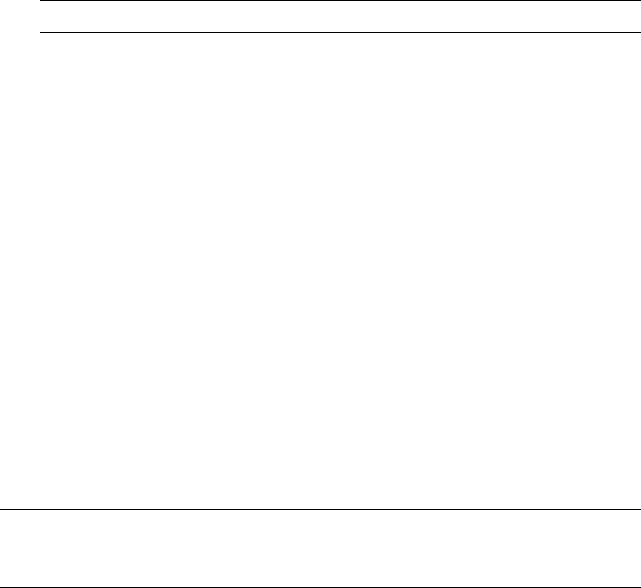
2Click a CV without releasing the mouse button. Drag to another CV, and
then release the mouse button.
The first CV you choose acquires the position of the second CV, and
becomes dependent to it. If the first CV has an animation controller, the
controller is discarded. If the second CV has an animation controller, the
first CV acquires it too.
NOTE Fused CVs display in purple by default.
To unfuse fused CVs
1Select the fused CV.
2Click Unfuse.
Now you can move and edit the two CVs independently.
To transform a region:
1Using sub-object selection, select one or more CVs for the center of
transformation.
2Turn on Soft Selection.
3Transform the CV.
A region around the selected CV is transformed accordingly.
Move is the most common transform to use. Rotate and Scale can be used
with a non-local transform center.
TIP If Soft Selection appears not to be working, the Falloff value might be too
small for the size of your surface. On the Soft Selection on page 2275 rollout,
increase the value of Falloff so it encompasses other CVs.
Interface
In addition to the CV rollout described here, the Surface CV sub-object level
also displays the Soft Selection rollout on page 2275 .
Creating and Editing NURBS Sub-Objects | 2247
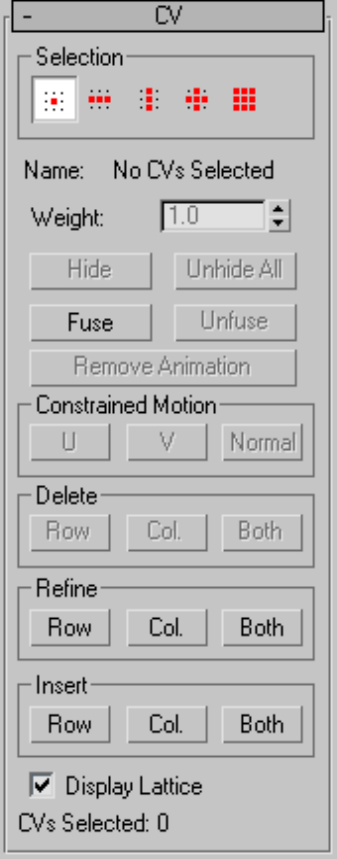
CV rollout
Surface CV sub-object rollout
2248 | Chapter 10 Surface Modeling

Selection group
Surface CV sub-object selection controls
Single CV (The default.) When on, you can select individual CVs by clicking,
or groups of CVs by dragging a region.
Row of CVs When on, clicking a CV selects the entire row the CV belongs
to. Dragging selects all rows in the region.
Column of CVs When on, clicking a CV selects the entire column the CV
belongs to. Dragging selects all columns in the region.
Row and Column of CVs When on, clicking a CV selects both the row and
column the CV belongs to. Dragging selects all rows and columns in the region.
All CVs When on, clicking or dragging selects all the CVs in the surface.
Name Shows either "No CVs selected", "Multiple CVs selected", or
"SurfaceName(uIndex,vIndex)", where "SurfaceName" is the name of the CV's
parent surface, and "uIndex,vIndex" is the CV's UV location on the surface.
You can't edit the Name field to customize the names of CVs.
If CVs are fused, the Name field shows the name of the first CV.
Weight Adjusts the weight of the selected CVs. You can use a CV's weight to
adjust the CV's effect on the surface. Increasing the weight pulls the surface
toward the CV. Decreasing the weight relaxes the surface away from the CV.
Increasing weight is a way to harden a surface: that is, to sharpen its curvature
at a particular location.
By default, the weight is 1.0 for the CVs of NURBS objects that you create on
the Create panel or the NURBS sub-object creation rollouts. The weight of
CVs in geometry that you convert to NURBS can vary, depending on the
object's original shape.
You can change the weight when multiple CVs are selected. Using the Weight
field or spinner while multiple CVs are selected assigns all of them the value
you choose. Because weights are relative to each other (rational), using the
Weight control when all CVs are selected has no visible effect.
Creating and Editing NURBS Sub-Objects | 2249

TIP You can increase the curvature of an indentation in a surface by increasing
the weight of the CVs surrounding the indented area. This is easier and often more
effective than moving the indented area's CVs.
Hide Click to hide the currently selected CVs.
Unhide All Click to unhide all hidden CVs.
Fuse Fuses a CV to another CV. (You can't fuse a CV to a point, or vice versa.)
This is one way to connect two surfaces. It is also a way to change the shape
of surfaces.
Fusing CVs does not combine the two CV sub-objects. They are connected but
remain distinct sub-objects that you can unfuse later.
Fused CVs behave as a single CV until you unfuse them. Fused CVs behave
similar to a single point, but the property of multiplicity for coincident CVs
also applies. (See NURBS Concepts on page 2176 and CV Curve on page 2208 .)
The fused CVs have proportionally more influence on the curve, which can
become sharper in the fused CVs' vicinity, or even angular if more than two
CVs are fused together.
Fused CVs are displayed in a distinct color. The default is purple. (You can
change this color using the Colors panel on page 7505 of the Customize User
Interface dialog on page 7489 .)
Unfuse Unfuses the fused CVs.
Remove Animation Removes animation controllers from the selected CVs.
Constrained Motion group
These buttons constrain CV motion. They are enabled when you select one
or more CVs. When you finish dragging the CV selection, the active constraint
button turns off.
UConstrains the CV selection to move in the surface's U dimension.
Keyboard shortcut (Keyboard Shortcut Override Toggle must be on): Alt+U
VConstrains the CV selection to move in the surface's V dimension.
Keyboard shortcut (Keyboard Shortcut Override Toggle must be on): Alt+V
Normal Constrains the CV selection to move normal to the original surface.
Keyboard shortcut (Keyboard Shortcut Override Toggle must be on): Alt+N
2250 | Chapter 10 Surface Modeling
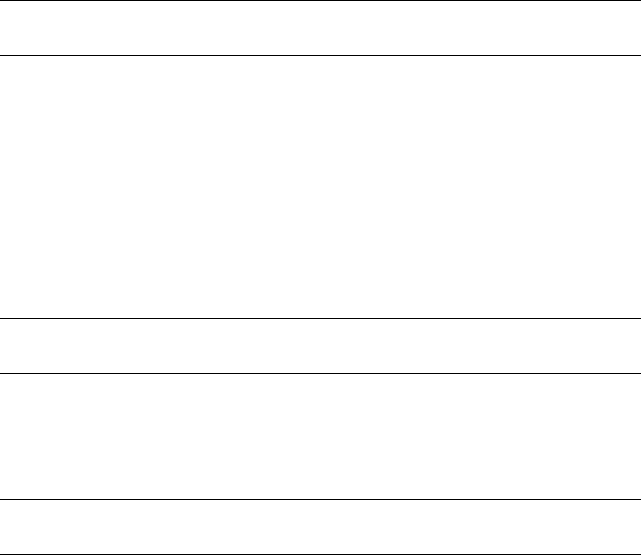
Delete group
These buttons delete CVs from the surface. Select one or more CVs, and then
click Row, Col., or Both.
You can't delete surface CVs if the deletion would give the surface fewer than
four rows or fewer than four columns. Aside from that restriction, these buttons
delete all rows, columns, or rows and columns that contain selected CVs. This
means that you can't delete after you make a selection using the Row and
Column or All selection buttons: that would imply deleting the entire CV
surface.
These buttons are unavailable unless the deletion is possible.
WARNING When you delete CVs, you lose the animation controllers for all CVs
on the surface.
Row Deletes rows of CVs from the surface.
Col. Deletes columns of CVs from the surface.
Both Deletes both rows and columns of CVs from the surface.
Refine group
These buttons refine the surface by adding CVs. As you move the mouse over
the surface, a preview of the CVs that will be added, and their locations, is
displayed in blue.
WARNING When you add CVs with Refine, you lose the animation controllers for
all CVs on the surface.
Row Adds a row of CVs to the surface.
Col. Adds a column of CVs to the surface.
Both Adds both a row and a column of CVs to the surface.
TIP It is a good idea to reparameterize after you have added CVs to a surface by
refining. See Editing Surface Sub-Objects on page 2264 .
Insert group
These buttons insert CVs into the curve. Click to turn on one of these buttons
and then click the surface where you want to insert the new CVs. Inserting
CVs is similar to refining with CVs, except that other CVs in the surface do
Creating and Editing NURBS Sub-Objects | 2251

not move. This means that the shape of the surface can change when you
insert.
Inserting CVs does not remove animation from the surface the way refining
does.
Row Inserts a row of CVs into the surface.
Col. Inserts a column of CVs into the surface.
Both Inserts both a row and a column of CVs into the surface.
TIP It is a good idea to reparameterize after you have added CVs to a surface by
inserting. See Editing Surface Sub-Objects on page 2264 .
Display Lattice When on, displays the control lattice on page 7745 that
surrounds CV surfaces. When off, the control lattice isn't shown in viewports.
Default=on.
CVs Selected This text field shows how many CVs are currently selected.
Editing Curve Sub-Objects
Modify panel > Stack display > Open the NURBS object's hierarchy. > Curve
sub-object level > Select curve sub-objects.
This topic describes the controls that are common to point and CV curves. A
rollout labeled Curve Common contains the curve sub-object controls for
NURBS models.
Procedures
To transform curves:
1At the Curve sub-object level, select one or more curves.
The sub-object selection tools are the same as for other kinds of
sub-objects. You can also press the H key when the Keyboard Shortcut
Override toggle on page 7646 is on. See Sub-Object Selection on page 2164
.
The Selection group box, described under "Interface" later in this topic,
provides additional options for selecting curves.
2Turn on Move or another transform and then drag in a viewport to
transform the selection.
The shape of the model changes as you interactively transform the curves.
2252 | Chapter 10 Surface Modeling
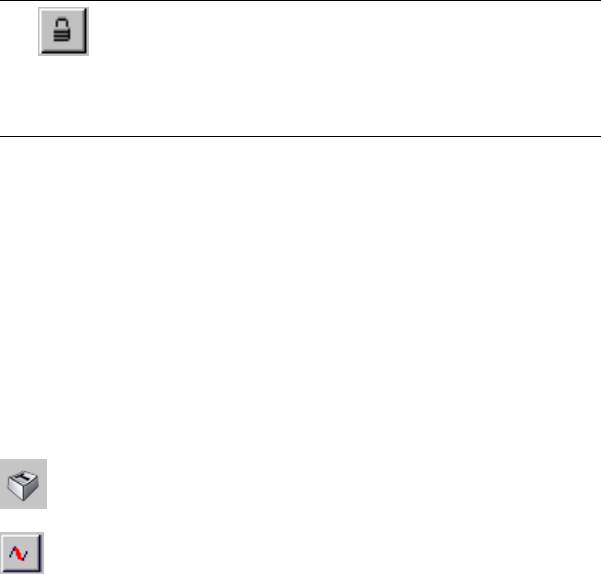
TIP The Lock Selection Set button is useful when you transform NURBS
curve sub-objects. You can make a selection in one viewport, click Lock
Selection Set (or press the Spacebar), and then transform the selection in a
different viewport.
To Shift+Clone curve sub-objects:
■Hold down Shift while you transform the curve selection.
The Sub-Object Clone Options on page 2466 dialog is displayed. This dialog
provides various ways to clone the curves, some of which reduce relational
dependencies to improve performance.
To use the keyboard to select curve sub-objects:
You can select curve sub-objects using the Ctrl key and the arrow keys. The
arrows traverse the sub-objects in the order they were created. To do so, follow
these steps:
1 Turn on the Keyboard Shortcut Override Toggle.
2 At the Curve sub-object level, set the selection controls to select
curves individually.
3Click or drag to select curves.
4Hold down Ctrl and use the arrow keys to move among the curves in the
current model.
At the Curve sub-object level, the left and right arrow keys move forward
and backward through individual curves in the order they were created.
The up and down arrows are equivalent to left and right.
You can also use the H keyboard shortcut (while the Keyboard Shortcut
Override Toggle is on) to display a dialog and select curves by name. Ctrl+H
displays only the names of curves directly beneath the mouse cursor.
To delete a curve:
■Select the curve and then click Delete.
Keyboard shortcut: Delete
Creating and Editing NURBS Sub-Objects | 2253

To turn a CV curve into a point curve:
1Select the curve sub-object, and then click Make Fit.
The Make Point Curve on page 2462 dialog is displayed. This dialog asks
how many points the new point curve should have.
2Change the number of points, and then click OK.
Reducing the number of points can change the shape of the curve.
If the selected curve is already a point curve, you can use Make Fit to change
the number of points it has.
To select a first vertex on the curve:
■Select the curve sub-object, turn on Make First, and then click a location
on the curve.
If the curve is closed and there is a vertex where you click, this vertex
becomes the first vertex. If the curve is closed and there is no vertex where
you click, a new vertex is created at the location you click. It becomes the
new first vertex, and the curve's points or CVs adapt to maintain the
curvature.
If the curve is open, clicking it has no effect.
WARNING Using Make First discards any animation controllers for the points or
CVs in the curve.
If the curve is open, the first vertex must be one of the endpoints (by default,
it is the first you created). The Make First button has no effect, but you can
use Reverse to change the curve's direction.
2254 | Chapter 10 Surface Modeling
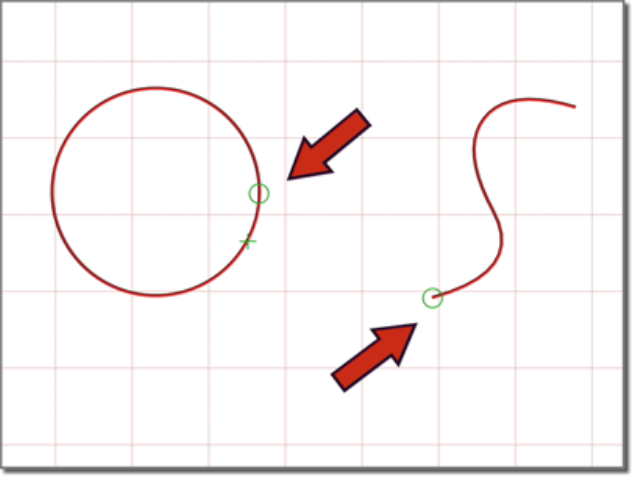
The small circle indicates the first vertex.
To turn a curve that lies on a surface into a Point Curve on Surface:
1Select the curve sub-object, and then click Make COS.
Make COS is unavailable unless the curve already lies on a surface; for
example, it is a U Iso curve.
2The Convert Curve on Surface dialog on page 2444 is displayed.
Creating and Editing NURBS Sub-Objects | 2255
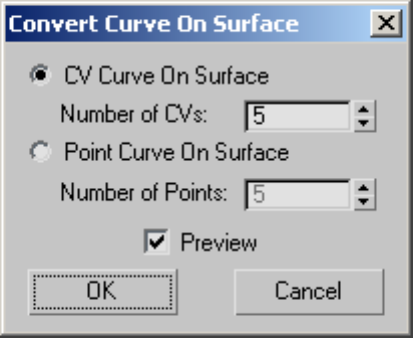
Choose CV Curve on Surface to create a CV curve, or Point Curve on
Surface to create a point curve. The Number of CVs or Number of Points
values let you specify the complexity and accuracy of the new curve on
surface. If Preview is on, the new curve is previewed in viewports. This
can help you choose the number.
To reverse a curve:
■Select a curve sub-object and then click Reverse.
2256 | Chapter 10 Surface Modeling
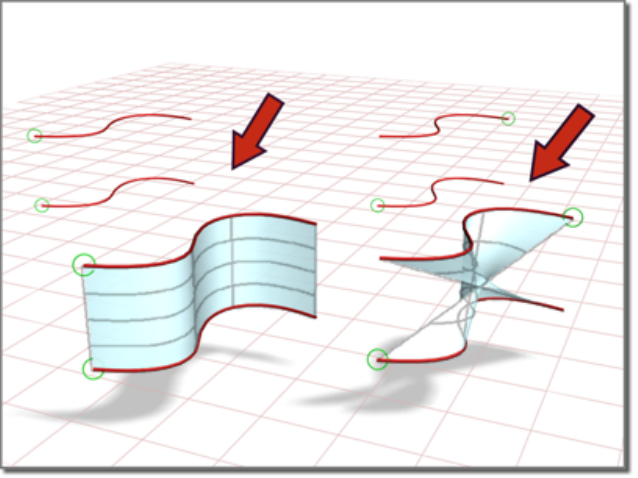
Reversing a curve affects the blend surface that depends on it.
To join two curves:
1In a NURBS object that contains two curve sub-objects, turn on Join.
2Click one curve near the end that you want to connect. Drag to near the
end of the other curve, and then release the mouse.
The Join Curve dialog on page 2456 is displayed. This dialog gives you a
choice of methods for joining the curves. Whichever method you choose,
the two original curves are replaced by a single curve.
3If the gap between the curves is small (less than about 30 units), use the
Join Curve dialog to set the Tolerance value greater than the distance of
the gap.
To break a curve:
■Turn on Break and then click a curve.
Creating and Editing NURBS Sub-Objects | 2257
The curve is split into two independent curve sub-objects. Two coincident
(but independent) points or CVs are created at the location you clicked:
each is the endpoint of one part of the original curve.
If the curve is a closed curve, Break creates a single curve object, with its
new start and end points at the location you clicked. The new start and
end points are coincident but independent.
To close a curve:
■Select the curve and then click Close.
The software closes the curve by adding a segment between the curve's
endpoints. The curvature of the new segment blends the curvature of the
previous end segments.
Closing a curve does not add points or CVs. The curve retains its original
number of points or CVs, and increases its number of segments by one.
2258 | Chapter 10 Surface Modeling
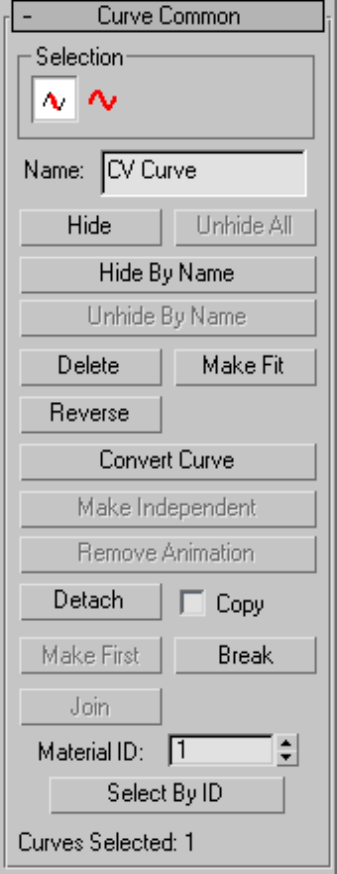
Interface
Curve Common rollout
Creating and Editing NURBS Sub-Objects | 2259
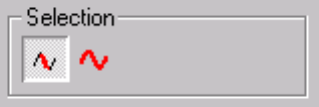
The controls on this rollout apply to all curve types. Depending on the type
of curve, an additional rollout is displayed with controls specific to that type
of curve.
Selection group
The selection buttons for curve sub-objects let you select either individual
curves, or curves that are connected in space.
Curve sub-object selection controls
Single Curve Clicking or transforming a curve selects only a single
independent curve sub-object.
All Connected Curves Clicking or transforming a curve selects all curve
sub-objects that are connected within the NURBS object. To be connected,
two curves must have fused points, or one curve must be a connected
dependent (a blend, fillet, or chamfer) of the other.
Name Shows the name of the currently selected curve. It is disabled if you
have selected multiple curves.
By default, the name is the name of the curve type ("CV Curve" or "Point
Curve") followed by a sequence number. You can use this field to give the
curve a name that you choose.
Hide Click to hide the currently selected curves.
Unhide All Click to unhide all hidden curves.
Hide by Name Click to display a Select Sub-Objects dialog that lists curves
by name. Select the curves to hide, then click Hide.
Unhide by Name Disabled unless there are hidden curves. Click to display
a Select Sub-Objects dialog that lists curves by name. Select the curves to make
visible, then click Unhide.
Delete Deletes the selected curve sub-objects.
Make Fit Turns a CV curve into a point curve. This displays the Make Point
Curve dialog on page 2462 , which lets you set the number of points.
For a point curve, this button lets you change the number of points in the
curve.
2260 | Chapter 10 Surface Modeling
Reverse Reverses the order of the CVs or points in a curve, so that the first
vertex becomes the last, and the last becomes the first.
The first point or CV is significant when you use the NURBS curve like a spline:
as a loft on page 715 path or shape, as a path constraint on page 3222 path, or
as a motion trajectory on page 3045 . For these purposes, the first vertex of the
curve is significant. If the curve is a closed curve, you can use Make First to
set the curve's first vertex.
The direction of the curve also determines the initial direction of normals on
surfaces based on this curve.
Make COS This button is enabled only for the following kinds of curves:
■U iso curves on page 2318
■V iso curves on page 2318
■Normal projected curves on page 2320
■Vector projected curves on page 2323
■Surface-surface intersection curves on page 2312
■Surface edge curves on page 2335
■CV curves on surfaces on page 2327
■Point curves on surfaces on page 2331
This displays a Make Curve on Surface dialog on page 2444 , which turns
the selected curve into a CV or point curve on surface. Once converted,
you can edit the new curve on surface using the curve on surface controls,
including the Edit Curve on Surface dialog on page 2450 .
If the curve is already a curve on surface, this button lets you change it
from a point to CV curve on surface, or vice versa.
The new Curve on Surface preserves the trimming of the original curve.
Convert Curve Click to display the Convert Curve dialog on page 2442 . This
dialog provides a more general way to convert a CV curve to a point curve,
or a point curve to a CV curve. It also lets you adjust a number of other curve
parameters.
Make Independent Disabled if the curve is independent. If the curve is
dependent, clicking this button makes it independent.
Creating and Editing NURBS Sub-Objects | 2261
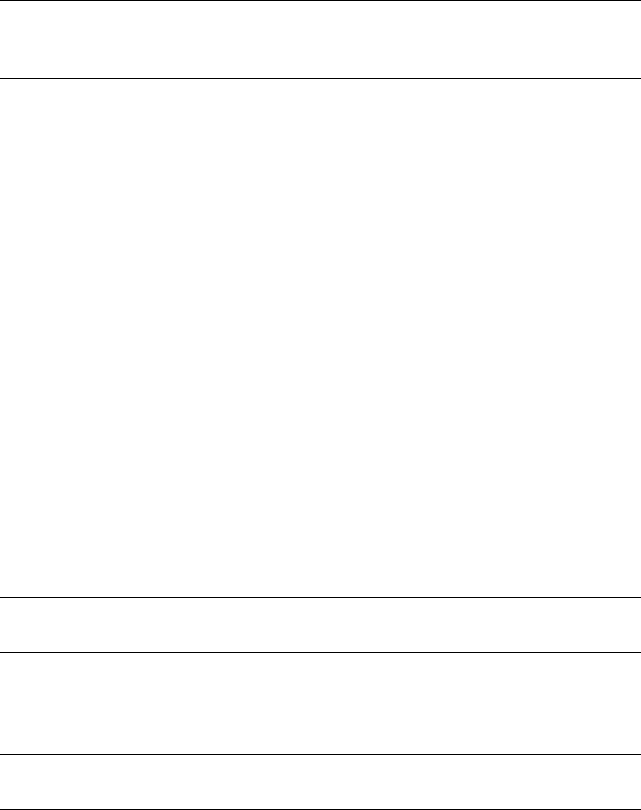
WARNING When you make a curve independent, you lose the animation
controllers for all objects that depend on it in turn. If you make a curve that trims
a surface independent, you lose the trimming of the surface.
Remove Animation Removes animation controllers from the selected curves.
Detach Detaches the selected curve sub-object from the NURBS model,
making it a new top-level NURBS curve on page 2199 object. The Detach dialog
on page 2449 is displayed, which lets you name the new curve. The new object
is no longer part of the original NURBS model.
To create a new top-level NURBS curve that is a copy of the selected curve,
turn on Copy before you click Detach.
Copy When on, clicking Detach creates a copy of the selected curve instead
of detaching it from the NURBS model. Default=off.
Make First For a closed curve, lets you choose a position that becomes the
first vertex of the curve.
The first point or CV is significant when you use the NURBS curve like a spline:
as a loft on page 715 path or shape, as a path constraint on page 3222 path, or
as a motion trajectory on page 3045 . For these purposes, the first vertex of the
curve is significant. If the curve is a closed curve, you can use Make First to
set the curve's first vertex.
Break Breaks a single curve into two curves. Click in a viewport to choose
the location to break the curve.
WARNING When you break a curve sub-object, you lose the animation controllers
for all points or CVs on the curve.
Join Joins two curve sub-objects together. After you have joined the curves
in a viewport, the Join Curves dialog on page 2456 is displayed. This dialog
lets you choose the method for joining the two curves.
WARNING When you join two curve sub-objects, you lose the animation controllers
for all points or CVs on both curves.
Material ID Lets you assign a material ID value to the curve. If the curve is
renderable, material IDs let you assign a material to the curve using a
Multi/Sub-Object on page 5558 material. In addition, the Select by ID button
lets you select a curve or multiple curves by specifying a material ID number.
Can range from 1 to 100. Default=1.
Select by ID Displays a Select by Material ID on page 2468 dialog.
2262 | Chapter 10 Surface Modeling
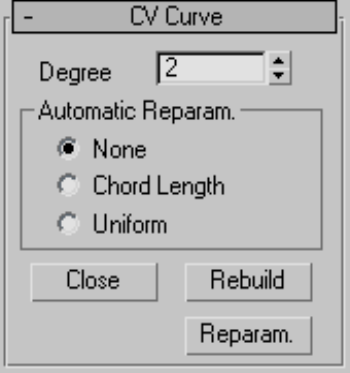
CV Curve rollout
This additional rollout is displayed when a CV curve is selected.
Degree Sets the degree of the curve. The higher the degree value, the greater
the continuity. The lower the degree, the more discontinuous the curve
segments become. The degree can't be less than one or greater than the number
allowed by the number of CVs in the curve. Degree 3 curves are adequate to
represent continuous curves, and are stable and well behaved. Default=3.
Setting the degree greater than 3 isn't recommended because higher-degree
curves are slower to calculate and less stable numerically. Higher-degree curves
are supported primarily to be compatible with models created using other
surface modeling programs.
The number of CVs in a CV curve must be at least one greater than the curve's
degree.
Automatic Reparameterization group
The controls in this group box let you specify automatic reparameterization.
They are similar to the controls in the Reparameterize dialog on page 2465 ,
with the addition that all choices except for None tell the software to
reparameterize the curve automatically; that is, whenever you edit it by moving
CVs, refining, and so on.
None Do not reparameterize automatically.
Chord Length Chooses the chord-length algorithm for reparameterization.
Creating and Editing NURBS Sub-Objects | 2263
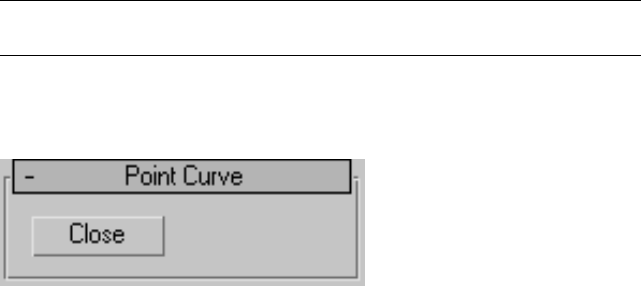
Chord-length reparameterization spaces knots (in parameter space on page
7882 ) based on the square root of the length of each curve segment.
Chord-length reparameterization is usually the best choice.
Uniform Spaces the knots uniformly.
A uniform knot vector has the advantage that the curve or surface changes
only locally when you edit it. With chord-length parameterization, moving
any CV can potentially change the entire curve.
Close Closes the curve. Disabled if the curve is already closed.
Rebuild Displays the Rebuild CV Curve dialog on page 2463 , which lets you
specify how to rebuild the curve. Rebuilding the curve can change its
appearance.
Reparam. Displays the Reparameterize dialog on page 2465 . Reparameterizing
a curve changes the curve's parameter space on page 7882 to provide a better
relation between control point locations and the shape of the curve.
TIP It is a good idea to reparameterize after you have added CVs to the curve by
refining or inserting.
Point Curve rollout
This additional rollout appears when a point curve is selected.
Close Closes the curve. Disabled if the curve is already closed.
Editing Surface Sub-Objects
Modify panel > Stack display > Open the NURBS object's hierarchy. > Surface
sub-object level > Select surface sub-objects.
This topic describes controls that are common to point surfaces, CV surfaces,
and the various dependent surface types. A rollout labeled Surface Common
contains the surface sub-object controls for NURBS surfaces. Another rollout,
Material Properties on page 2278 , controls mapping on surface sub-objects, and
2264 | Chapter 10 Surface Modeling
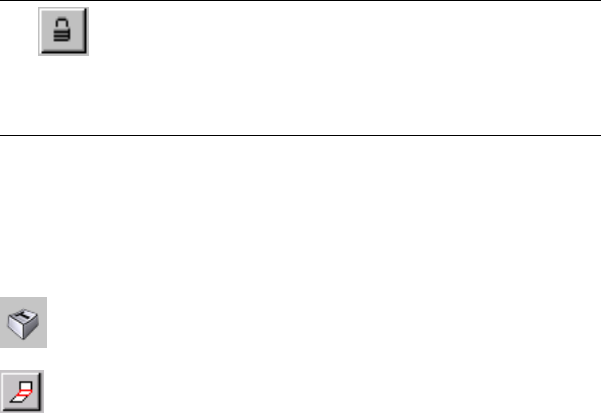
is described in its own topic. See Surface Approximation on page 2469 for a
description of that rollout. The final rollout for surface sub-objects depends
on the type of surface selected.
Procedures
To transform surface sub-objects:
1At the Surface sub-object level, select one or more surface sub-objects.
The sub-object selection tools are the same as for other kinds of
sub-objects. In addition, you can use the H key when the Keyboard
Shortcut Override toggle on page 7646 is on. See Sub-Object Selection on
page 2164 .
The Selection group box, described under "Interface" later in this topic,
provides additional options for selecting surfaces.
2Turn on Move or another transform and then drag in a viewport to
transform the selection.
The shape of the model changes as you interactively transform the
surfaces.
TIP The Lock Selection Set button is useful when you transform NURBS
sub-objects. You can make a selection in one viewport, click Lock Selection
Set (or press the Spacebar), and then transform the selection in a different
viewport.
To use the keyboard to select surface sub-objects:
You can select surface sub-objects using the Ctrl key and the arrow keys. The
arrows traverse the sub-objects in the order they were created. To do so, follow
these steps:
1 Turn on the Keyboard Shortcut Override Toggle.
2 At the Surface sub-object level, set the selection controls to select
surfaces individually.
3Click or drag to select surfaces.
Creating and Editing NURBS Sub-Objects | 2265
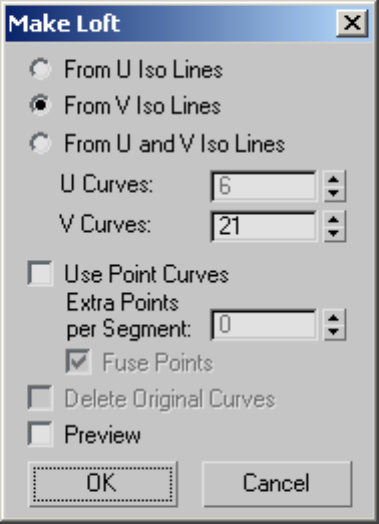
4Hold down Ctrl and use the arrow keys to move among surfaces in the
current model.
At the Surface sub-object level, the left and right arrow keys move forward
and backward through individual surfaces in the order they were created.
The up and down arrows are equivalent to left and right.
You can also use the H keyboard shortcut (while the Keyboard Shortcut
Override Toggle is on) to display a dialog and select surfaces by name. Ctrl+H
displays only the names of surfaces directly beneath the mouse cursor.
To delete a surface:
■Select the surface and then click Delete.
Keyboard shortcut: Delete
To make a surface a loft:
1Select the surface and then click Make Loft. A Make Loft dialog on page
2459 is displayed.
2266 | Chapter 10 Surface Modeling

2Use the Make Loft dialog controls to choose the settings for the new
surface, and then click OK.
To break a surface:
1Turn on Break Row, Break Col., or Break Both, and then drag over the
surface.
One or two blue curves appear on the surface to indicate where the break
will occur.
2When you have dragged to the location you want to break, click the
surface.
NOTE If you break a dependent surface, the new "broken" surfaces are made
independent.
You cannot break a trimmed surface.
To extend a surface:
1Turn on Extend.
2Move the mouse over the surface without depressing the mouse button.
The edge that will be extended is highlighted in blue.
3When the edge you want to extend is highlighted, press the mouse button,
and then drag vertically to increase the length of the surface.
The surface extension is invalid and disappears if it would cause the surface
to intersect itself or if the edge of the surface touches itself but is not closed.
For example, you can't extend the top of a cylinder.
To join two surfaces:
1In a NURBS object that contains two surface sub-objects, turn on Join.
2If the gap between the surfaces is small (less than about 30 units), set the
Tolerance value greater than the distance of the gap.
3Click one surface near the edge that you want to connect. The edge that
will be connected is highlighted in blue. Drag to choose the edge you
want to connect. Without releasing the mouse button, drag to the other
surface. The edge of the other surface is also highlighted in blue. Drag
on the other surface to choose the edge to connect, and then release the
mouse button.
Creating and Editing NURBS Sub-Objects | 2267
The surface that owns the highlighted edge is highlighted in yellow, to
help you distinguish which edge you are choosing when two surfaces
have coincident edges.
The Join Surfaces dialog on page 2458 is displayed, which gives you a
choice of methods for how to join the surfaces. Whichever method you
choose, the software creates a single surface that replaces the two original
surfaces.
To close a surface:
■Select the surface sub-object and then click Close Rows or Close Cols.
2268 | Chapter 10 Surface Modeling
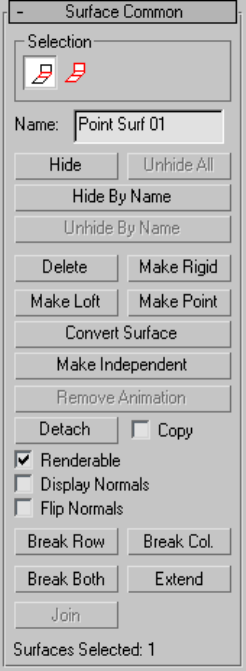
Interface
Surface Common rollout
Surface sub-object rollout
The controls on this rollout apply to all surface types. Depending on the type
of surface, an additional rollout is displayed with controls specific to that type
of surface.
Selection group
The selection buttons for surface sub-objects let you select either individual
surfaces, or surfaces that are connected in space.
Creating and Editing NURBS Sub-Objects | 2269

Surface sub-object selection controls
Single Surface Clicking or transforming a surface selects only a single surface
sub-object.
All Connected Surfaces Clicking or transforming a surface selects all surface
sub-objects that are connected within the NURBS object. To be connected,
two surfaces must have all the CVs on a shared edge fused between them, or
one surface must be a connected dependent of the other (for example, a blend
or a cap).
Name Shows the name of the currently selected surface. It is disabled if you
have selected multiple surfaces.
By default, the name is the name of the surface type ("CV Surface," "Point
Surface," "Blend Surface," and so on) followed by a sequence number. You can
use this field to give the surface a name that you choose.
Hide Click to hide the currently selected surface.
Unhide All Click to unhide all hidden surfaces.
Hide by Name Click to display a Select Sub-Objects dialog that lists surfaces
by name. Select the surfaces to hide, then click Hide.
Unhide by Name Disabled unless there are hidden surfaces. Click to display
a Select Sub-Objects dialog that lists surfaces by name. Select the surfaces to
make visible, then click Unhide.
Delete Deletes the selected surface sub-objects.
Make Rigid Makes the surface rigid. The only editing allowed on a rigid
surface is to transform it at the Surface sub-object level. You can't move a rigid
surface's points or CVs, or change the number of points or CVs.
Rigid surfaces reduce the amount of memory used by the NURBS model.
Making surfaces rigid improves performance, especially for large and complex
models.
When a surface is rigid, you can't see its points or CVs when you are at the
Point or Surface CV sub-object levels. If the model has no nonrigid surfaces
and no point curves, the Point and Surface CV sub-object levels aren't available
at all.
2270 | Chapter 10 Surface Modeling
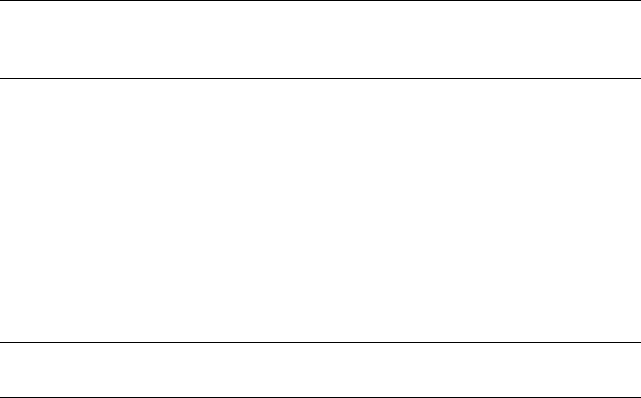
To make a surface no longer rigid, click Make Point or Make Independent.
Editing the surface with Break, Join, and so on also makes it no longer rigid.
Make Loft Displays a Make Loft dialog on page 2459 to convert the surface
sub-object to a (dependent) U loft or UV loft surface. Can also change the
dimension used to construct a U loft surface.
You can’t use Make Loft if the surface sub-object is in an error condition.
TIP Make Loft creates a loft with uniformly spaced curves. To make a loft with
adaptively spaced iso curves, manually create the curves and then loft them with
U Iso Lines, V Iso Lines, or U and V Iso Lines.
Make Point Displays a Make Point dialog on page 2461 to convert any kind
of surface to a point surface. You can also use Make Point to change the
number of rows and columns if the surface is already a point surface.
Convert Surface Click to display the Convert Surface dialog on page 2445 .
This dialog provides a general way to convert a surface to a different type of
surface. You can convert between lofts, point ("fit") surfaces, and CV surfaces.
The dialog also lets you adjust a number of other surface parameters.
Make Independent Disabled if the surface is independent. If the surface is
dependent, clicking this button makes it independent.
WARNING When you make a surface independent, you lose the animation
controllers for all objects that depend on it in turn.
Remove Animation Removes animation controllers from the selected surfaces.
Detach Detaches the selected surface sub-object from the NURBS model,
making it a new top-level NURBS surface object on page 2190 . The Detach
dialog on page 2449 is displayed, which lets you name the new surface. The
new object is no longer part of the original NURBS model.
To create a new top-level NURBS surface that is a copy of the selected surface,
turn on Copy before you click Detach.
Copy When on, clicking Detach creates a copy of the selected surface instead
of detaching it from the NURBS model. Default=off.
Renderable When on, the surface renders. Turn off to make the surface
invisible in renderings. Default=on.
Display Normals When on, the normal for each selected surface is displayed.
There is one normal per surface sub-object. The normal is displayed at the
surface's UV origin, so displaying normals can help you see how materials will
Creating and Editing NURBS Sub-Objects | 2271
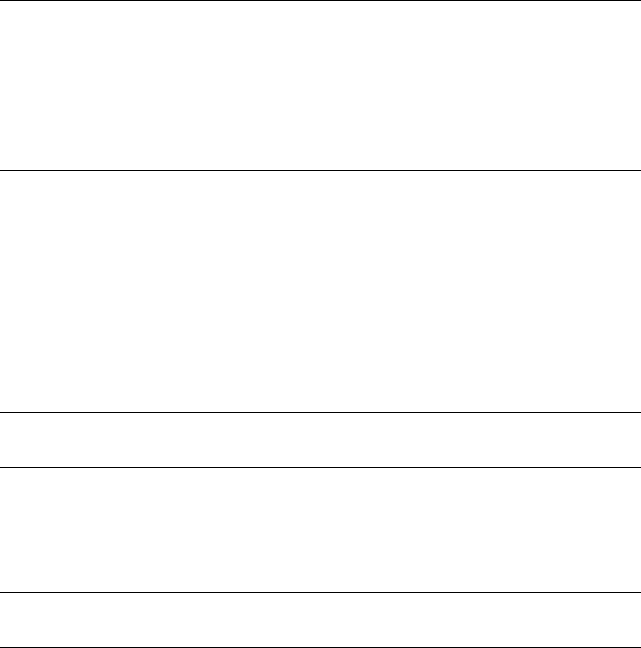
be mapped. On the other hand, the normal can be hard to see if you are
zoomed out. Default=off.
Flip Normals Turn on to reverse the direction of the surface normals.
Default=off.
TIP The Flip Normals control is useful for viewing a surface that is mostly concave
or mostly convex. With more complicated NURBS surfaces, you often want to
render both sides of the surface. Turn on Force 2-Sided in the Render Scene dialog
on page 5878 to see both sides of the surface. To see both sides of the surfaces in
viewports, turn on Force 2-Sided in the Rendering Method panel of the Viewport
Configuration dialog on page 7610 , or assign a Double-Sided Material on page 5551
.
Break Row Breaks the surface into two surfaces in the direction of a row (the
surface's U axis).
Break Col. Breaks the surface into two surfaces in the direction of a column
(the surface's V axis).
Break Both Breaks the surface into four surfaces in both directions.
You cannot break a trimmed surface.
Extend Extends the surface by changing its length.
WARNING Extending a surface loses all animation controllers for the surface and
its points or CVs.
Join Joins two surface sub-objects together. After you have joined the surfaces
in a viewport, the Join Surfaces dialog on page 2458 is displayed. This dialog
lets you choose the method for joining the two surfaces. You can join only
original edges of surfaces; you cannot join edges created by trimming.
WARNING When you join two surface sub-objects, you lose the animation
controllers for all point or CVs on both surfaces.
CV Surface rollout
This additional rollout is displayed when a CV surface is selected.
2272 | Chapter 10 Surface Modeling
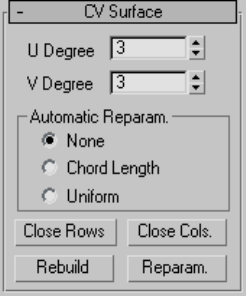
U Degree and V Degree Let you set the degree of the surface in either the
U or V dimension. The higher the degree value, the greater the continuity.
The lower the degree, the more discontinuous the surface segments become.
The degree can't be less than one or greater than the number allowed by the
number of CVs in the specified dimension. Degree 3 is adequate to represent
continuous surfaces, and is stable and well behaved. Default=3.
Setting the degree greater than 3 isn't recommended because higher-degrees
are slower to calculate and less stable numerically. Higher-degrees are supported
primarily to be compatible with models created using other surface modeling
programs.
The number of CVs in a given dimension must be at least one greater than
that dimension's degree.
Automatic Reparameterization group
The controls in this group box let you specify automatic reparameterization.
They are similar to the controls in the Reparameterize dialog on page 2465 ,
with the addition that all choices except for None tell the software to
reparameterize the curve automatically; that is, whenever you edit it by moving
CVs, refining, and so on.
None Do not reparameterize automatically.
Chord Length Chooses the chord-length algorithm for reparameterization.
Chord-length reparameterization spaces knots (in parameter space on page
7882 ) based on the square root of the length of each curve segment.
Chord-length reparameterization is usually the best choice.
Uniform Spaces the knots uniformly.
Creating and Editing NURBS Sub-Objects | 2273
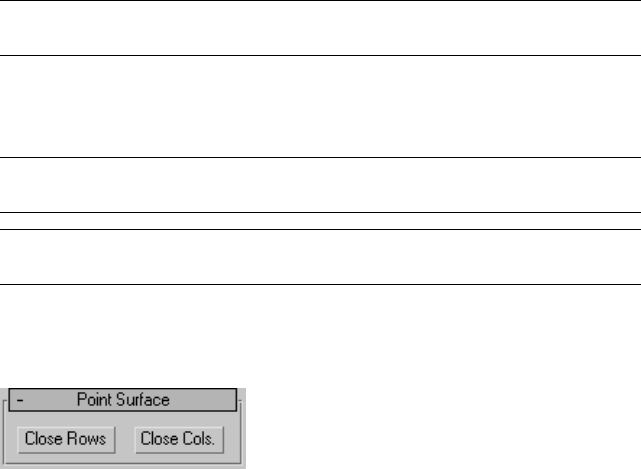
A uniform knot vector has the advantage that the curve or surface changes
only locally when you edit it. With chord-length parameterization, moving
any CV can potentially change the entire surface.
The close controls let you close a surface. They are displayed on the CV Surface
rollout while an independent CV surface sub-object is selected. They are
disabled if the surface is already closed in that direction.
Close Rows Closes the surface by joining the ends of its rows.
Close Cols. Closes the surface by joining the ends of its columns.
Rebuild Displays the Rebuild CV Surface dialog on page 2464 , which lets you
specify how to rebuild the surface. Rebuilding the surface can change its
appearance.
WARNING When you rebuild a surface, you lose the animation controllers for all
CVs on the surface.
Reparam. Displays the Reparameterize dialog on page 2465 . Reparameterizing
a surface changes the surface's parameter space on page 7882 to provide a better
relation between control point locations and the shape of the surface.
TIP It is a good idea to reparameterize after you have added CVs to the surface
by refining or inserting.
WARNING When you reparameterize a surface, you lose the animation controllers
for all CVs on the surface.
Point Surface rollout
This additional rollout appears when a point surface is selected.
The close controls let you close a surface. They appear on the Point Surface
rollout while an independent point surface sub-object is selected. They have
no effect if the surface is already closed in that direction.
Close Rows Closes the surface by joining the ends of its rows.
Close Cols. Closes the surface by joining the ends of its columns.
2274 | Chapter 10 Surface Modeling
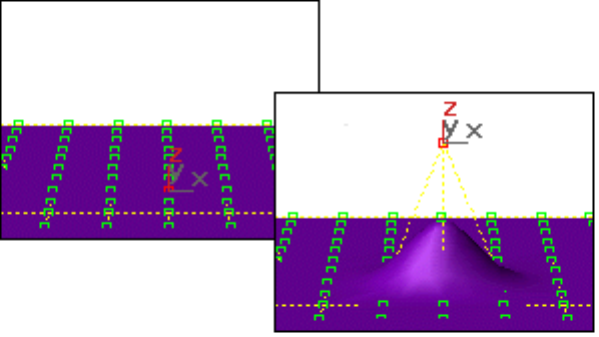
Soft Selection Rollout (NURBS)
Modify panel > Select NURBS point or CV sub-objects. > Soft Selection rollout
The soft selection controls for NURBS models are like the soft selection controls
for editable mesh on page 1990 objects. Soft selection controls make a point
or CV behave as if surrounded by a "magnetic field." Unselected points or CVs
within the field are drawn along smoothly while you move the selected one.
With this feature, you can sculpt the points or CVs of a curve or surface. For
example, you can draw a sphere into an egg, or gently curve a flat surface into
hills and valleys.
With soft selection, transforming a single vertex can move others.
The Soft Selection rollout for point and CV sub-objects contains the controls
for this feature. The Soft Selection check box is turned off by default.
Before you begin, you might need to increase the number of CVs or points
on the surface. This allows smoother and more complex reshaping effects.
A single point or CV works well for many purposes. Moving a point or CV
along a single axis is the most useful for smoothly raising and lowering surfaces.
For multiple points or CVs, you can also use Rotate or Scale.
Creating and Editing NURBS Sub-Objects | 2275
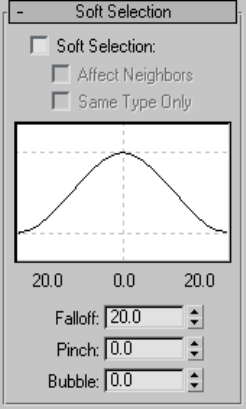
Interface
Soft Selection When on, point or CV transforms affect a region of the curve
or surface.
Affect Neighbors When on, the transform affects points or CVs not only on
this curve or surface but within the entire Falloff region of the NURBS object.
Same Type Only (for point curves and surfaces only) When on, the transform
affects only neighboring points of the same type; that is, either curve points,
surface points, or independent points.
Soft Selection Curve This curve display shows how Soft Selection will work.
You can experiment with a curve setting, undo it, and try another setting with
the same selection.
Falloff Distance in current units from the center to the edge of a sphere
defining the region. Use higher falloff settings to achieve more gradual slopes,
depending on the scale of your geometry. Default=20.
2276 | Chapter 10 Surface Modeling
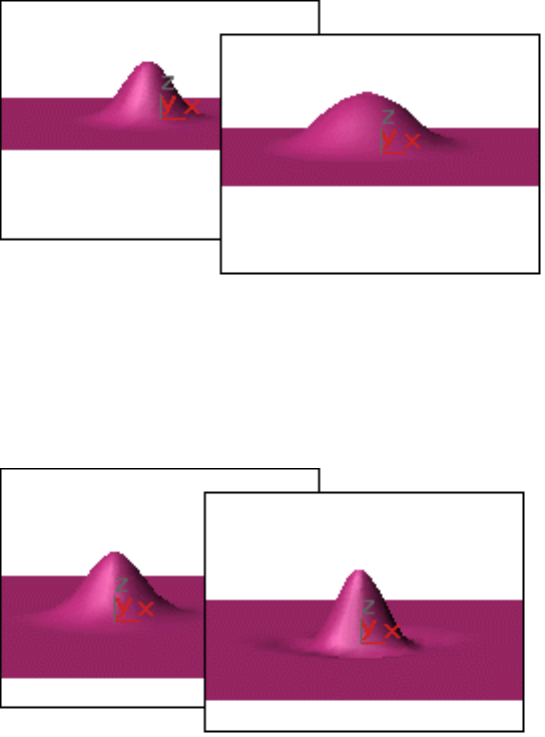
Left: Falloff=20 (the default)
Right: Falloff=40
Pinch Raises and lowers the top point of the curve along the vertical axis.
Sets the relative "pointedness" of the region. When negative, a crater is
produced instead of a point. At a setting of 0, Pinch produces a smooth
transition across this axis. Default=0.
Left: Pinch=.5
Right: Pinch=2
Falloff and Bubble have their default values.
Bubble Expands and contracts the curve along the vertical axis. Sets the
relative "fullness" of the region. Limited by Pinch, which sets a fixed starting
point for Bubble. A setting of 0 for Pinch and 1.0 for Bubble produces a
maximum smooth bulge. Negative values for Bubble move the bottom of the
curve below the surface, creating a "valley" around the base of the region.
Default=0.
Creating and Editing NURBS Sub-Objects | 2277
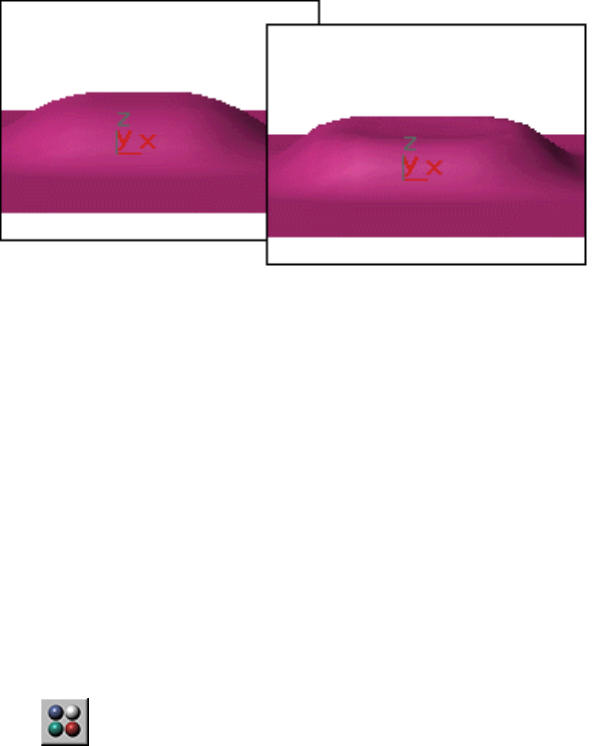
Left: Bubble=1
Right: Bubble=6
Falloff and Pinch have their default values.
Material Properties Rollout
Modify panel > Select NURBS object. > Stack display > Surface sub-object level
> Material Properties rollout
This rollout controls material mapping onto a NURBS surface sub-object.
Procedures
To apply a mapped material to a surface sub-object:
1On the Material Properties rollout, turn on Gen. Mapping Coordinates.
2 Use the Material Editor on page 5188 to assign a mapped material
to the surface.
To use multiple map channels on a single surface sub-object (example):
1On the Material Properties rollout, turn on Gen. Mapping Coordinates.
2Change the Map Channel value to 2, and turn on Gen. Mapping
Coordinates.
3Change the U and V tiling values for map channel 2.
2278 | Chapter 10 Surface Modeling
Now when you assign a mapped material, maps on map channel 1 use
the default UV tiling, while maps on map channel 2 use the channel 2
tiling. An easy way to see this is to create a checker on page 5646 map on
channel 1, and make one checker color another checker map on channel
2.
Creating and Editing NURBS Sub-Objects | 2279
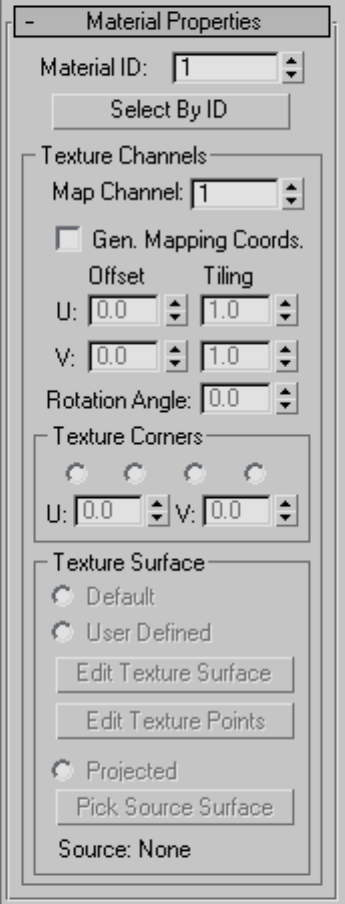
Interface
Material Properties rollout
2280 | Chapter 10 Surface Modeling
Material ID Use this to change the surface’s material ID number. Multiple
material IDs in a single NURBS object let you assign a multi/sub-object material
on page 5558 to the NURBS object.
Select by ID Displays a Select by Material ID dialog on page 2468 .
Texture Channels group
The controls in this group box support materials, including tiling and
positioning mapping coordinates on the surface.
Map Channel Chooses a UV coordinates map channel on page 7836 . Range=1
to 99. A single surface can use up to 99 texture channels. Default=1.
Gen. Mapping Coordinates Generates mapping coordinates so you can apply
mapped materials to the surface. Each surface in a NURBS object has its own
set of mapping coordinates. Default=off.
U and V Offset Offset mapping coordinates along the surface’s local U axis
or V axis. That is, at 0.0 (the default), the map begins at the U or V origin.
Increasing an Offset value moves the map forward along that axis, and
decreasing it moves it backward. These parameters are animatable.
U and V Tiling Control the tiling of UV mapping coordinates; that is, the
number of times a mapped material’s map is repeated in the surface’s local U
axis or V axis. Default=1.0 for both axes (no tiling). These parameters are
animatable.
Rotation Angle Lets you specify a rotation angle for the texture. This
parameter is animatable.
Texture Corners group
The controls in this group box let you explicitly set which texture surface UV
values to use at the corners of a surface. These controls are especially useful
when you are matching the textures of adjacent surfaces.
These controls are disabled unless Generate Mapping Coordinates is on.
Corners radio buttons The four buttons correspond to the four corners of
the currently selected surface. When you choose a button, the corresponding
corner is highlighted with a blue box in 3D viewports, and the U and V
spinners are enabled.
U and V Unavailable unless you've chosen one of the Corners radio buttons.
When available, you use these spinners to set the U and V texture values for
the chosen corner.
Creating and Editing NURBS Sub-Objects | 2281

By default, the U and V values for most surfaces range from 0.0 to 1.0. For
some kinds of geometry converted to a NURBS surface, these ranges can vary.
Texture Surface group
The controls in this group box let you choose a method for mapping texture
to the currently selected NURBS surface sub-object, and to adjust the parameters
for some of the chosen methods.
These controls are available when Generate Mapping Coordinates is on.
A texture surface is a surface associated with the surface sub-object. The texture
surface controls how materials are mapped. In effect, changing the texture
surface stretches or otherwise changes the UV coordinates for the surface,
altering the mapping.
Maps can shift with certain surface approximation methods. This effect is
especially noticeable when the surface has animated CVs. You can reduce or
eliminate map shifting by changing the mapping method to User Defined.
TIP Don't use the UVW Map modifier to apply a texture to an animated NURBS
surface.
Default Automatically generates a texture surface. This method evenly
distributes the texture and attempts to compensate for stretching of the surface.
The default texture surface method has no additional controls.
User Defined Generates a texture surface that you can edit. You edit the
user-defined texture surface either by using an Edit Texture Surface dialog (as
you did in 3ds Max prior to v3), or by editing texture points directly in
viewports.
Edit Texture Surface Click to display the Edit Texture Surface dialog on page
2453 , which lets you control UV mapping on this surface. This button is available
when you've chosen User Defined as the texture surface method.
Edit Texture Points Click to edit texture surface points directly in viewports.
This button available when you've chosen User Defined as the texture surface
method.
While Edit Texture Points is on, the points of the texture surface are displayed
in viewports, where you can adjust their positions by using the selection and
transform tools.
Projected Generates the texture surface by projecting the texture of another
NURBS surface sub-object in the NURBS model. The projection travels along
the direction of the normals of the source surface.
2282 | Chapter 10 Surface Modeling
Projected texture surfaces are relational: if you update the source surface, the
texture updates on all the surfaces it projects onto.
If you use the same source surface to project a texture onto several other
connected surfaces, the textures will match along the boundaries where the
mapped surfaces touch.
Pick Source Surface This button is available when you've chosen Projected
as the texture surface method. To choose a source (projector) surface, choose
Projected, click to turn on this button, and then click in a viewport to select
another surface sub-object in the same NURBS model.
Source text field If Projected is the chosen texture surface method and you
have picked a surface to project, this field displays the name of the projector
(source) surface. Otherwise, this field says "None."
Creating Curve Sub-Objects
Select NURBS object. > Modify panel > Create Curves rollout
Select NURBS object. > Modify panel > NURBS toolbox
Keyboard > Ctrl+T to toggle NURBS toolbox display (Keyboard Shortcut
Override Toggle must be on)
Curve sub-objects are either independent point and CV curves (similar to the
top-level point and CV curves described in Point Curve on page 2201 and CV
Curve on page 2208 ), or they are dependent curves. Dependent curves are curve
sub-objects whose geometry depends on other curves, points, or surfaces in
the NURBS object. When you change the geometry of the original, parent
sub-objects, the dependent curve changes as well.
You create curve sub-objects using the Create Curves rollout on the Modify
command panel for a NURBS curve.
Creating and Editing NURBS Sub-Objects | 2283
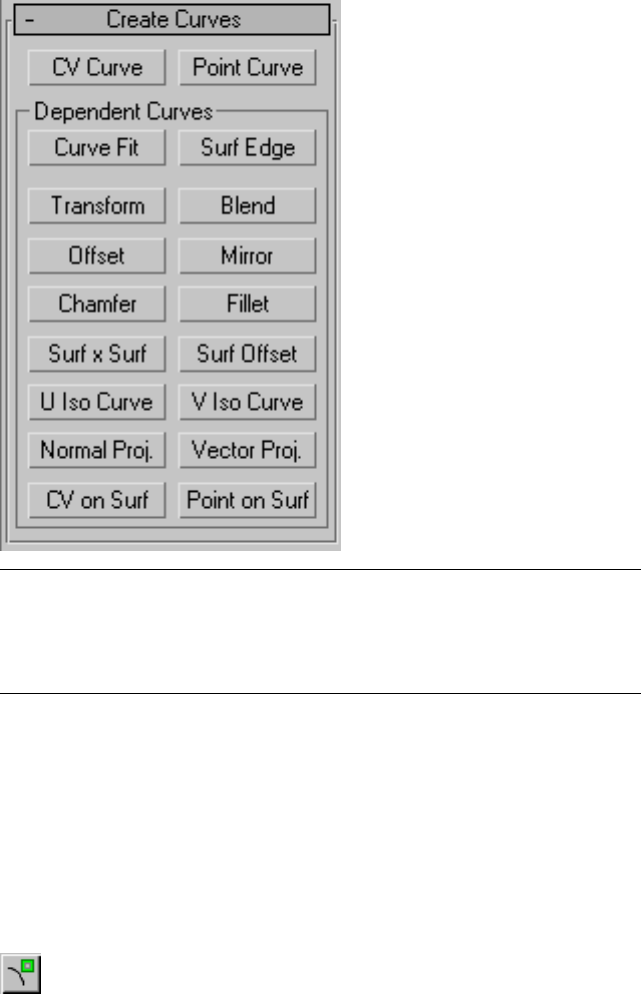
TIP Lathe and extrude surface sub-objects can be based on only a single curve;
see Creating Dependent Surfaces on page 2337 . If you create dependent curves
and then want to use the set of curves (for example, two parents and a fillet
between them) as the basis of an extrude or loft surface, first go to the Curve
sub-object level and use Join to connect the curves.
Creation operations for dependent sub-objects require you to select one or
more parent objects. In general, you can click and drag, or click and then click
again. You can also use the H keyboard shortcut to display the Select
Sub-Objects dialog. This is a subset of the Selection Floater on page 171 for
choosing the parent. (The Keyboard Shortcut Override Toggle on page 7646
must be on for H to work this way.)
Toolbox Buttons for Creating Curves
These are the toolbox on page 2162 buttons for creating curve sub-objects:
Create an independent CV curve sub-object on page 2286 .
2284 | Chapter 10 Surface Modeling

Create an independent point curve sub-object on page 2290 .
Create a dependent fit curve (as with the Curve Fit on page 2293 button).
Create a dependent transform curve on page 2294 .
Create a dependent blend curve on page 2296 .
Create a dependent offset curve on page 2299 .
Create a dependent mirror curve on page 2301 .
Create a dependent chamfer curve on page 2303 .
Create a dependent fillet curve on page 2308 .
Create a dependent surface-surface intersection curve on page 2312 .
Create a dependent U iso curve on page 2318 .
Create a dependent V iso curve on page 2318 .
Create a dependent normal projected curve on page 2320 .
Create a dependent vector projected curve on page 2323 .
Create a dependent CV curve on surface on page 2327 .
Create a dependent point curve on surface on page 2331 .
Create a dependent surface offset curve on page 2316 .
Creating and Editing NURBS Sub-Objects | 2285
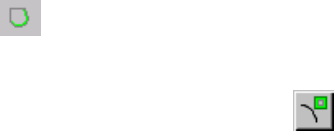
Create a dependent surface edge curve on page 2335 .
CV Curve Sub-Object
Select NURBS object. > Modify panel > Create Curves rollout > CV Curve
button
Select NURBS object. > Modify panel > NURBS toolbox > Create CV Curve
button
CV curve sub-objects are similar to object-level CV curves on page 2208 . The
main difference is that you can't give CV curves a renderable thickness at the
sub-object level.
Drawing Three-Dimensional Curves
When you create a CV curve, you can draw it in three dimensions. There are
two ways to do this:
■Draw In All Viewports: This toggle lets you use any viewport to draw the
curve, enabling you to draw three dimensionally.
■Using Ctrl to drag CVs: While you draw a curve, you can use the Ctrl key
to drag a CV off of the construction plane.
With the Ctrl–key method, further mouse movement lifts the latest point off
the construction plane. There are two ways to use this:
■Click-drag. If you hold down Ctrl and also hold down the mouse button,
you can drag to change the height of the CV. The CV's location is set when
you release the mouse button.
This method is probably more intuitive.
■Click-click. If you Ctrl+click and then release the mouse button, the height
changes as you drag the mouse. Clicking the mouse a second time sets the
CV's location.
This method is less prone to repetitive stress injury.
While you are offsetting the CV, a red dotted line is drawn between the original
CV on the construction plane and the actual CV offset from the plane. You
can move the mouse into an inactive viewport, in which case the software
2286 | Chapter 10 Surface Modeling
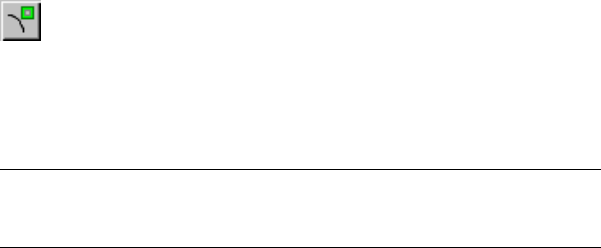
sets the height of the CV using the CV's Z axis in the inactive viewport. This
lets you set the height of the CV with accuracy.
Snaps on page 2578 also work when you change the height of a CV. For example,
if you turn on CV snapping, you can set a CV to have the same height as
another CV by snapping to that other CV in an inactive viewport.
Procedures
To create a CV curve sub-object:
1 Turn on CV Curve.
2In a viewport, click and drag to create the first CV, as well as the first
curve segment. Release the mouse button to add the second CV. Each
subsequent location you click adds a new CV to the curve. Right-click to
end curve creation.
NOTE If you begin the curve by clicking without dragging, this also creates
the curve's first CV. However, if you release the mouse button more than five
pixels away from where you initially pressed it, this creates an additional CV.
While you are creating a CV curve, you can press Backspace to remove
the last CV you created, and then previous CVs in reverse order.
If Draw In All Viewports is on, you can draw in any viewport, creating a
3D curve.
To lift a CV off the construction plane, use the Ctrl key as described earlier
in this topic under "Drawing Three-Dimensional Curves."
As with splines, if you click over the curve's initial CV, a Close Curve
dialog on page 2448 is displayed. This dialog asks whether you want the
curve to be closed. Click No to keep the curve open or Yes to close the
curve. (You can also close a curve when you edit it at the Curve sub-object
level.) When a closed curve is displayed at the Curve sub-object level, the
initial CV is displayed as a green circle, and a green tick mark indicates
the curve's direction.
Creating and Editing NURBS Sub-Objects | 2287
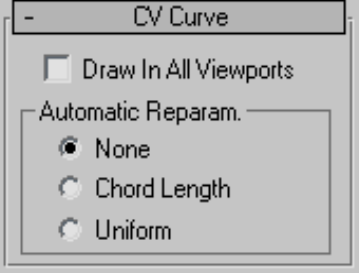
Interface
CV Curve rollout (creation time)
Draw In All Viewports Lets you use any viewport while you are drawing the
curve. This is one way to create a 3D curve. When off, you must finish drawing
the curve in the viewport where you began it. Default=on.
While Draw In All Viewports is on, you can also use snaps on page 2578 in any
viewport.
Automatic Reparameterization group
The controls in this group box let you specify automatic reparameterization.
They are similar to the controls in the Reparameterize dialog on page 2465 ,
with one addition: all choices except for None tell the software to
reparameterize the curve automatically; that is, whenever you edit it by moving
CVs, refining, and so on.
None Do not reparameterize automatically.
Chord Length Chooses the chord-length algorithm for reparameterization.
Chord-length reparameterization spaces knots (in parameter space on page
7882 ) based on the square root of the length of each curve segment.
Chord-length reparameterization is usually the best choice.
Uniform Spaces the knots uniformly.
A uniform knot vector has the advantage that the curve or surface changes
only locally when you edit it. With the other two forms of parameterization,
moving any CV can change the entire sub-object.
2288 | Chapter 10 Surface Modeling
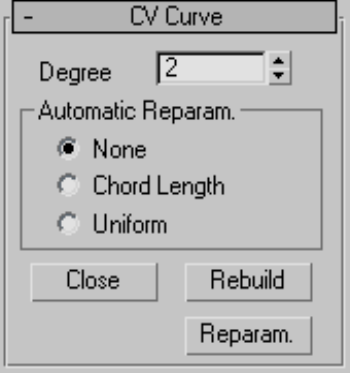
CV Curve rollout (modification time)
Degree Sets the degree of the curve. The higher the degree value, the greater
the continuity. The lower the degree, the more discontinuous the curve
segments become. The degree can't be less than one or greater than the number
allowed by the number of CVs in the curve. Degree 3 curves are adequate to
represent continuous curves, and are stable and well behaved. Default=3.
Setting the degree greater than 3 isn't recommended, because higher-degree
curves are slower to calculate and less stable numerically. Higher-degree curves
are supported primarily to be compatible with models created using other
surface modeling programs.
The number of CVs in a CV curve must be at least one greater than the curve's
degree.
Automatic Reparameterization group
The controls in this group box let you specify automatic reparameterization.
They are similar to the controls in the Reparameterize dialog on page 2465 ,
with one addition: all choices except for None tell the software to
reparameterize the curve automatically; that is, whenever you edit it by moving
CVs, refining, and so on.
None Do not reparameterize automatically.
Chord Length Chooses the chord-length algorithm for reparameterization.
Creating and Editing NURBS Sub-Objects | 2289

Chord-length reparameterization spaces knots (in parameter space on page
7882 ) based on the square root of the length of each curve segment.
Chord-length reparameterization is usually the best choice.
Uniform Spaces the knots uniformly.
A uniform knot vector has the advantage that the curve or surface changes
only locally when you edit it. With the other two forms of parameterization,
moving any CV can change the entire sub-object.
Close Closes the curve. Disabled if the curve is already closed.
Rebuild Displays the Rebuild CV Curve dialog on page 2463 to let you rebuild
the CV curve.
Reparam Displays the Reparameterize dialog on page 2465 to let you re
parameterize the CV.
Point Curve Sub-Object
Select NURBS object. > Modify panel > Create Curves rollout > Point Curve
button
Select NURBS object. > Modify panel > NURBS toolbox > Create Point Curve
button
Point curve sub-objects are similar to object-level point curves on page 2201 .
Points are constrained to lie on the curve. The main difference is that you
can't give point curves a renderable thickness at the sub-object level.
Drawing Three-Dimensional Curves
When you create a point curve, you can draw it in three dimensions. There
are two ways to do this:
■Draw In All Viewports: This toggle lets you use any viewport to draw the
curve, enabling you to draw three dimensionally.
■Using Ctrl to drag points: While you draw a curve, you can use the Ctrl key
to drag a point off of the construction plane.
2290 | Chapter 10 Surface Modeling
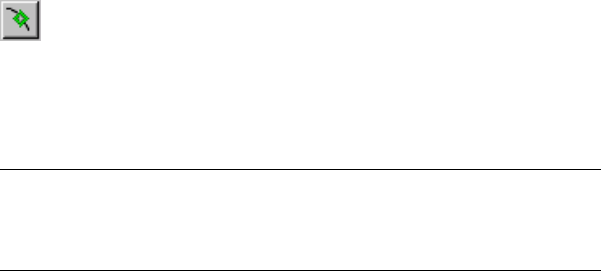
With the Ctrl key method, further mouse movement lifts the latest point off
the construction plane. There are two ways to use this:
■Click-drag. If you hold down Ctrl and also hold down the mouse button,
you can drag to change the height of the point. The point's location is set
when you release the mouse button.
This method is probably more intuitive.
■Click-click. If you Ctrl+click and then release the mouse button, the height
changes as you drag the mouse. Clicking the mouse a second time sets the
point's location.
This method is less prone to repetitive stress injury.
While you are offsetting the point, a red dotted line is drawn between the
original point on the construction plane and the actual point offset from the
plane. You can move the mouse into an inactive viewport, in which case the
software sets the height of the point using the point's Z axis in the inactive
viewport. This lets you set the height of the point with accuracy.
Snaps on page 2578 also work when you change the height of a point. For
example, if you turn on Point snapping, you can set a point to have the same
height as another point by snapping to that other point in an inactive
viewport.
Procedures
To create a point curve sub-object:
1 Turn on Point Curve.
2In a viewport, click and drag to create the first point, as well as the first
curve segment. Release the mouse button to add the second point. Each
subsequent location you click adds a new point to the curve. Right-click
to end curve creation.
NOTE If you begin the curve by clicking without dragging, this also creates
the curve's first point. However, if you release the mouse button more than
five pixels away from where you initially pressed it, this creates an additional
point.
While you are creating a point curve, you can press Backspace to remove
the last point you created, and then previous points in reverse order.
If Draw In All Viewports is on, you can draw in any viewport, creating a
3D curve.
Creating and Editing NURBS Sub-Objects | 2291
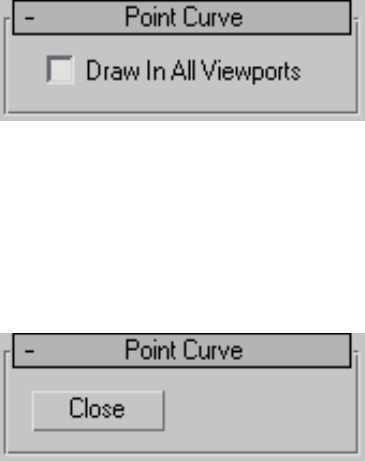
To lift a point off the construction plane, use the Ctrl key as described
earlier in this topic under Drawing Three-Dimensional Curves on page
2290 .
As with splines, if you click over the curve's initial point, a Close Curve
dialog on page 2462 is displayed. This dialog asks whether you want the
curve to be closed. Click No to keep the curve open or Yes to close the
curve. (You can also close a curve when you edit it at the Curve sub-object
level.) When a closed curve is displayed at the Curve sub-object level, the
initial point is displayed as a green circle, and a green tick mark indicates
the curve's direction.
Interface
Point Curve rollout (creation time)
Draw In All Viewports Lets you use any viewport while you are drawing the
curve. This is one way to create a 3D curve. When off, you must finish drawing
the curve in the viewport where you began it. Default=on.
While Draw In All Viewports is on, you can also use snaps on page 2578 in any
viewport.
Point Curve rollout (modification time)
Close Closes the curve. Disabled if the curve is already closed.
2292 | Chapter 10 Surface Modeling
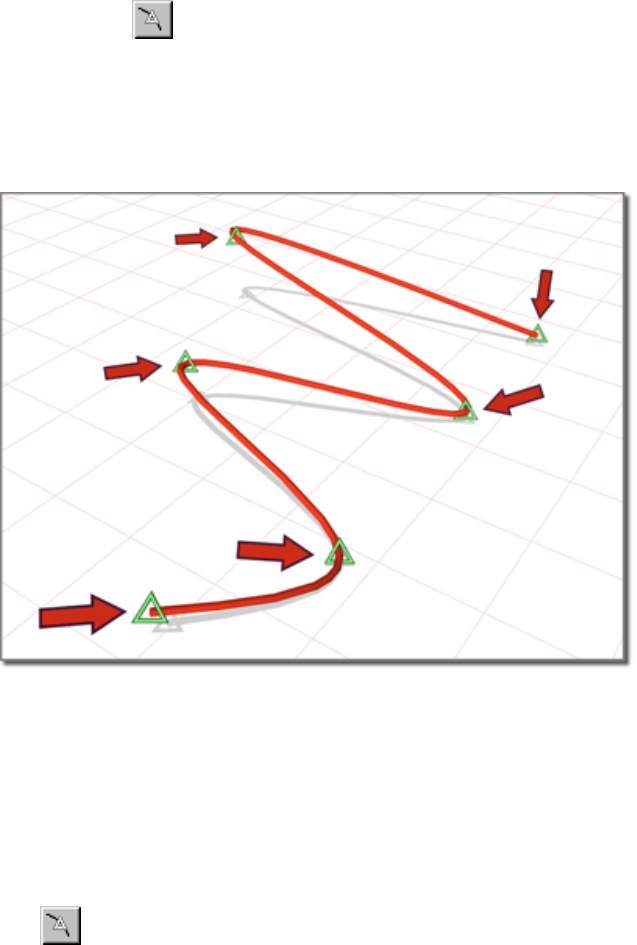
Curve Fit
Select NURBS object. > Modify panel > Create Curves rollout > Dependent
Curves group box > Curve Fit button
Select NURBS object. > Modify panel > NURBS toolbox > Create Fit Curve
button
Fitting a curve to selected points
This command creates a point curve fitted to points you select. The points
can be part of previously created point curve and point surface objects, or
they can be point sub-objects you created explicitly. They can't be CVs.
Procedures
To create a point curve with Curve Fit:
1 Turn on Curve Fit.
2Click to select two or more points.
Creating and Editing NURBS Sub-Objects | 2293

A point curve is created. It runs through the points you select, in the
order you select them.
You can use Backspace to undo point selection in reverse order.
3Right-click to end creation.
Interface
There are no parameters for a point curve created with Curve Fit.
Transform Curve
Select NURBS object. > Modify panel > Create Curves rollout > Dependent
Curves group box > Transform button
Select NURBS object. > Modify panel > NURBS toolbox > Create Transform
Curve button
A transform curve is a copy of the original curve with a different position,
rotation, or scale.
2294 | Chapter 10 Surface Modeling
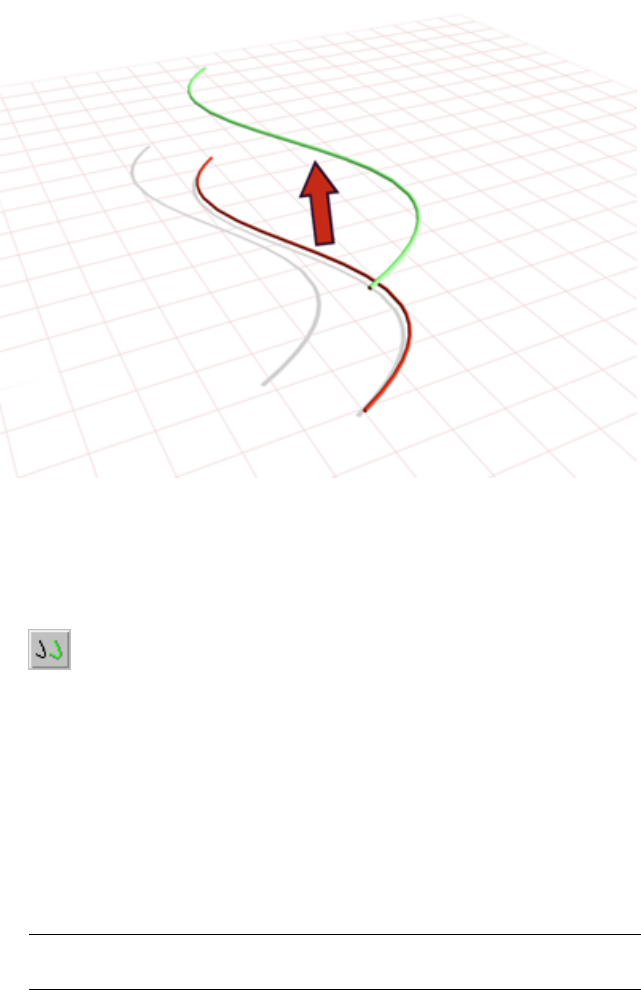
Curve used to create a transform curve
Procedures
To create a transform curve:
■ In a NURBS object that contains at least one curve, turn on Transform.
To move the transform curve, click and drag the curve you want to
duplicate. To rotate or scale the transform curve, click the parent curve,
click to turn on Sub-Object on the Modifier Stack rollout, choose Curve
from the drop-down list, and then use a transform to rotate or scale the
transform curve.
When you use Move to create the transform curve, it simply copies the
parent. (It doesn't exaggerate curvature as an offset curve does.)
Axis constraints don't apply to the creation of transform curves. You can
click to create the curve in place; then once it is created, transform it using
constraints.
TIP You can also use axis constraints by using Shift+clone at the Curve
sub-object level.
Creating and Editing NURBS Sub-Objects | 2295
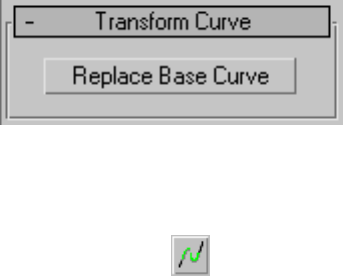
Interface
Creation time
At creation time, transform curves have no parameters.
Transform Curve rollout (modification time)
At modification time, you can transform the transform curve as a curve
sub-object, and you can animate curve sub-object transforms. Transform curves
also have one control in the Modify panel.
Replace Base Curve Lets you replace the parent curve. Click the button, then
click the curve to replace the original curve.
Blend Curve
Select NURBS object. > Modify panel > Create Curves rollout > Dependent
Curves group box > Blend button
Select NURBS object. > Modify panel > NURBS toolbox > Create Blend Curve
button
A blend curve connects the end of one curve to the end of another, blending
the curvature of the parents to create a smooth curve between them. You can
blend curves of the same type, a point curve with a CV curve (and vice versa),
an independent curve with a dependent curve, and so on.
2296 | Chapter 10 Surface Modeling
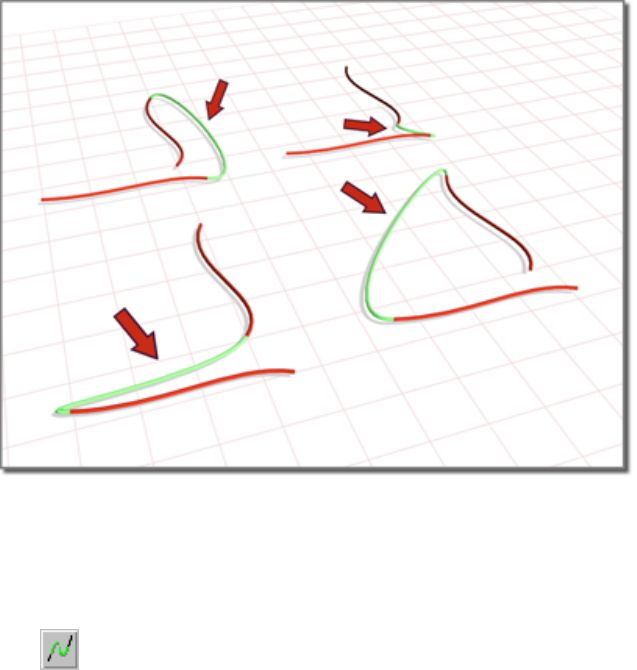
Blend curves connecting original curves
Procedures
To create a blend curve:
1 In a NURBS object that contains two curves, turn on Blend.
2Click one curve near the end that you want to connect. The end that will
be connected is highlighted. Without releasing the mouse button, drag
to the end of the other curve that you want to connect. The other end
is highlighted as well. When the end that you want to connect is
highlighted, release the mouse button.
After the blend curve is created, changing the position or the curvature
of either parent curve changes the blend curve as well.
3Adjust the blend parameters.
Creating and Editing NURBS Sub-Objects | 2297
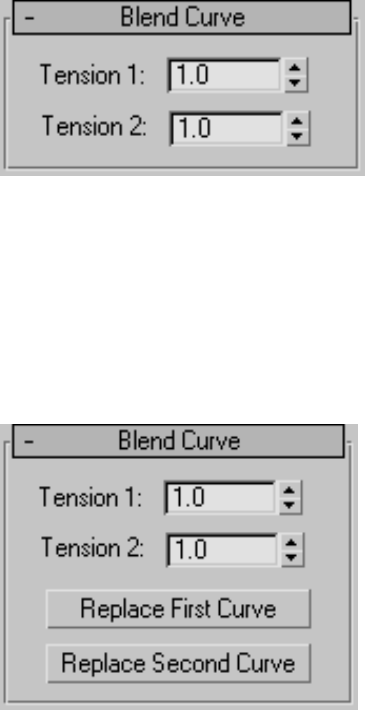
Interface
Blend Curve rollout (creation time)
"Tension" affects the tangent between a parent curve and the blend curve.
The greater the tension value, the more closely the tangent parallels the parent
curve, and the smoother the transition. The lower the tension, the greater the
tangent angle and the sharper the transition between parent and blend.
Tension 1 Controls tension at the edge of the first curve you clicked.
Tension 2 Controls tension at the edge of the second curve you clicked.
Blend Curve rollout (modification time)
"Tension" affects the tangent between a parent curve and the blend curve.
The greater the tension value, the more closely the tangent parallels the parent
curve, and the smoother the transition. The lower the tension, the greater the
tangent angle and the sharper the transition between parent and blend.
Tension 1 Controls tension at the edge of the first curve you clicked.
Tension 2 Controls tension at the edge of the second curve you clicked.
2298 | Chapter 10 Surface Modeling
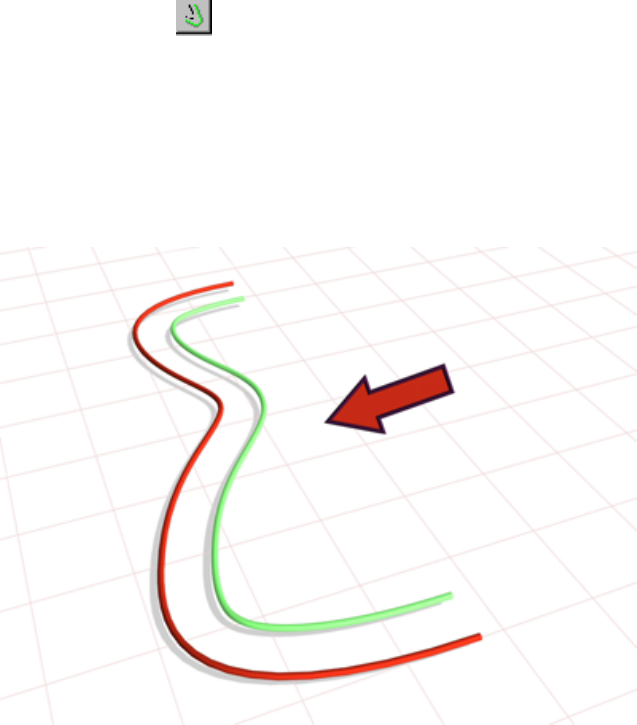
Replace First Curve and Replace Second Curve Let you replace the parent
curves. Click the button, then click the curve to replace the original first or
second curve.
Offset Curve
Select NURBS object. > Modify panel > Create Curves rollout > Dependent
Curves group box > Offset button
Select NURBS object. > Modify panel > NURBS toolbox > Create Offset Curve
button
An Offset curve is offset from the original, parent curve. It is normal to the
original. You can offset both planar and 3D curves.
Curve used to create an offset curve
Creating and Editing NURBS Sub-Objects | 2299
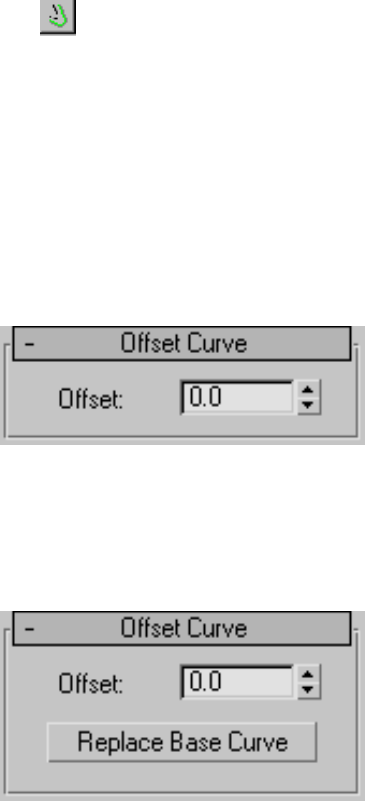
Procedures
To create an offset curve:
1 In a NURBS object that contains at least one curve, turn on Offset.
2Click the curve you want to offset, and drag to set the initial distance.
An offset curve is created.
3Adjust the Offset parameter.
If the parent curve is not linear, increasing the distance increasingly
exaggerates the curvature of the offset curve.
Interface
Offset Curve rollout (creation time)
Offset The distance between the parent curve and the offset curve, in 3ds
Max units.
This parameter is animatable.
Offset Curve rollout (modification time)
Offset The distance between the parent curve and the offset curve, in 3ds
Max units.
Replace Base Curve Lets you replace the parent curve. Click the button, then
click the curve to replace the original curve.
2300 | Chapter 10 Surface Modeling
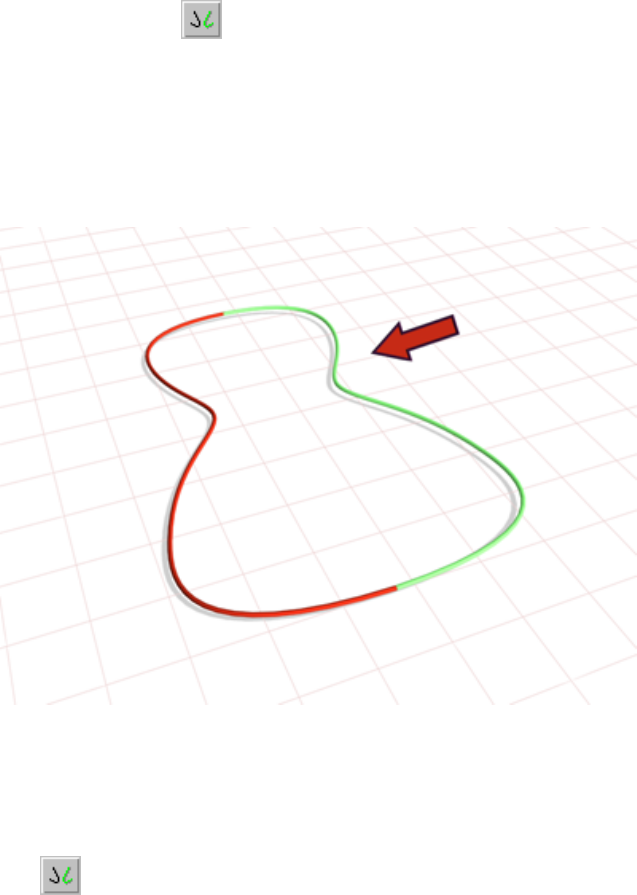
Mirror Curve
Select NURBS object. > Modify panel > Create Curves rollout > Dependent
Curves group box > Mirror button
Select NURBS object. > Modify panel > NURBS toolbox > Create Mirror Curve
button
A mirror curve is a mirror image of the original curve.
Curve used to create a mirror curve
Procedures
To create a mirror curve:
1 In a NURBS object that contains at least one curve, turn on Mirror.
2On the Mirror Curve rollout, choose the axis or plane you want to use.
3Click the curve you want to mirror, and drag to set the initial distance.
Creating and Editing NURBS Sub-Objects | 2301
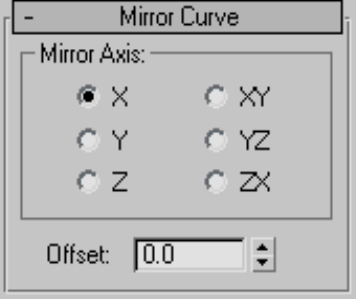
A mirror curve is created. A gizmo (yellow by default) indicates the
direction of mirroring. Transforming the mirror curve's gizmo changes
the orientation of the mirror, letting you mirror along an axis that isn't
aligned with a local coordinate axis.
4Adjust the mirror parameters.
Interface
In viewports a gizmo (yellow by default) indicates the mirror axis.
Mirror Curve rollout (creation time)
Mirror Axis group
The Mirror Axis buttons control the direction in which the original curve is
mirrored.
You can't transform the mirror curve directly (that would simply transform
the mirror curve and its parent curve at the same time). You transform it by
transforming its gizmo. By using transforms you can mirror about an arbitrary
axis, rather than using one of the Mirror Axis presets. When you transform a
mirror curve, you are actually transforming the mirror plane, so Rotate has
the effect of rotating the plane about which the curve is mirrored. (This is like
rotating the mirror gizmo in the Mirror modifier.)
Offset Controls the mirror's distance from the original curve.
This parameter is animatable.
2302 | Chapter 10 Surface Modeling
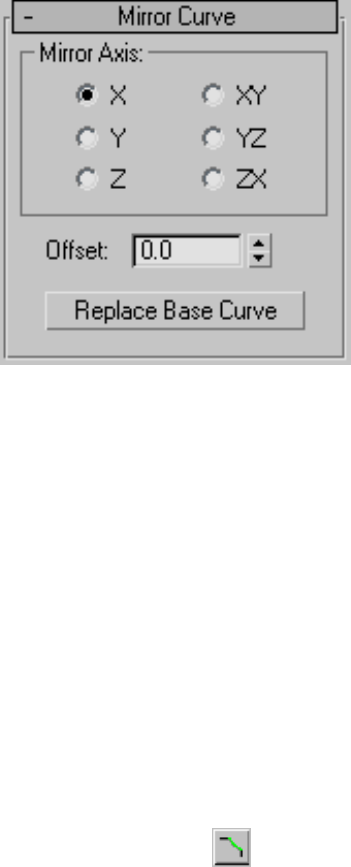
Mirror Curve rollout (modification time)
Mirror Axis group
The Mirror Axis buttons control the direction in which the original curve is
mirrored.
You can't transform the mirror curve directly (that would simply transform
the mirror curve and its parent curve at the same time). You transform it by
transforming its gizmo. By using transforms you can mirror about an arbitrary
axis, rather than using one of the Mirror Axis presets. When you transform a
mirror curve, you are actually transforming the mirror plane, so Rotate has
the effect of rotating the plane about which the curve is mirrored. (This is like
rotating the mirror gizmo in the Mirror modifier.)
Offset Controls the mirror's distance from the original curve.
This parameter is animatable.
Replace Base Curve Lets you replace the parent curve. Click the button, then
click the curve to replace the original curve.
Chamfer Curve
Select NURBS object. > Modify panel > Create Curves rollout > Dependent
Curves group box > Chamfer button
Creating and Editing NURBS Sub-Objects | 2303
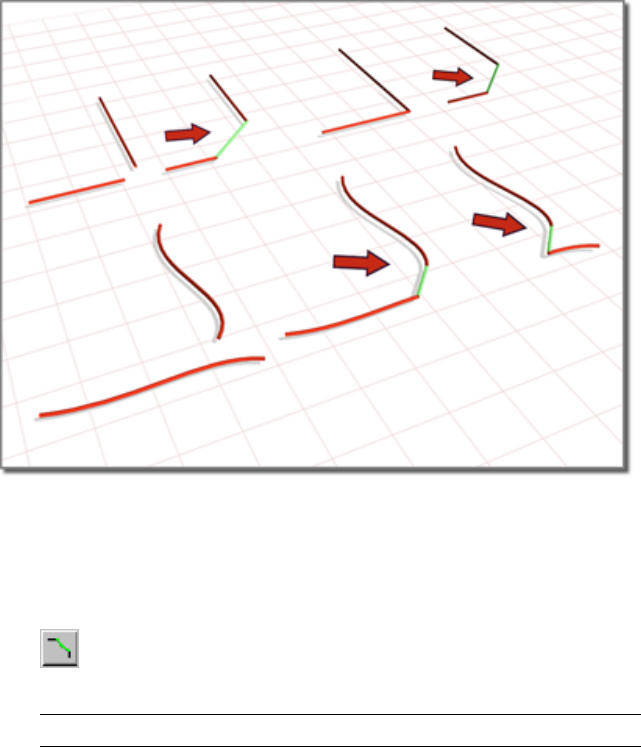
Select NURBS object. > Modify panel > NURBS toolbox > Create Chamfer
Curve button
Chamfer creates a curve that is a straight bevel between two parent curves.
Creating chamfers between two original curves
Procedures
To create a chamfer curve:
1 In a NURBS object that contains at least two curves, turn on
Chamfer.
TIP Make sure the curves intersect before you begin to create the chamfer.
2Click one curve near the end that you want to connect. The end that will
be connected is highlighted. Without releasing the mouse button, drag
to the end of the other curve that you want to connect. When the end
that will be connected is highlighted, release the mouse button.
2304 | Chapter 10 Surface Modeling
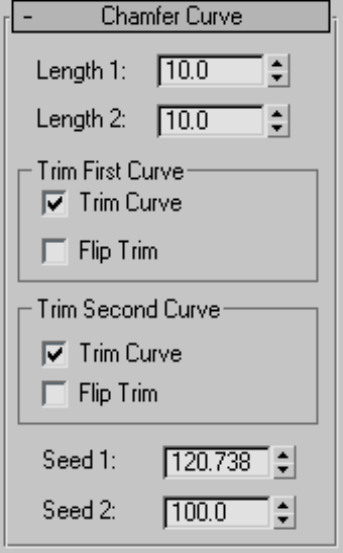
A chamfer curve is created. Changing the position or the curvature of
either parent curve can change the chamfer as well.
The parent curves must be coplanar. The chamfer is not necessarily
connected at the endpoints of the parent curves: you can adjust its
position with the chamfer's Length parameters.
3Adjust the chamfer parameters.
Interface
Chamfer Curve rollout (creation time)
The lengths are the distances from the intersection (or apparent intersection)
at which the chamfer segment is drawn.
Length 1 The distance along the first curve you click.
This parameter is animatable.
Creating and Editing NURBS Sub-Objects | 2305
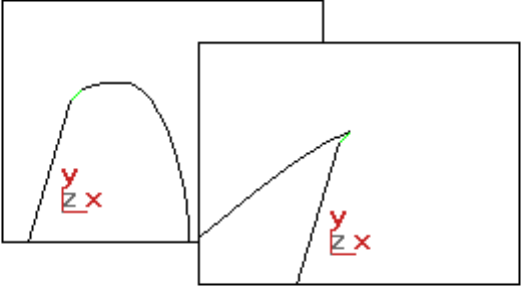
Length 2 The distance along the second curve you click.
This parameter is animatable.
Some length values make it impossible to construct the chamfer. If you set
the length to an invalid value, the chamfer returns to a default position and
is displayed in the error color (orange by default).
Trim First Curve and Trim Second Curve groups
These two group boxes let you control how the parent curves are trimmed.
The controls are the same in each. "First" and "second" refer to the order in
which you picked the parent curves.
Flipping the direction of a trim
Trim Curve When on (the default), trims the parent curve against the fillet
curve. When off, the parent isn't trimmed.
Flip Trim When on, trims in the opposite direction.
Seed 1 and Seed 2 Change the U location of the seed value on the first and
second curves. If there is a choice of directions, the direction indicated by the
seed points is the one used to create the chamfer.
2306 | Chapter 10 Surface Modeling
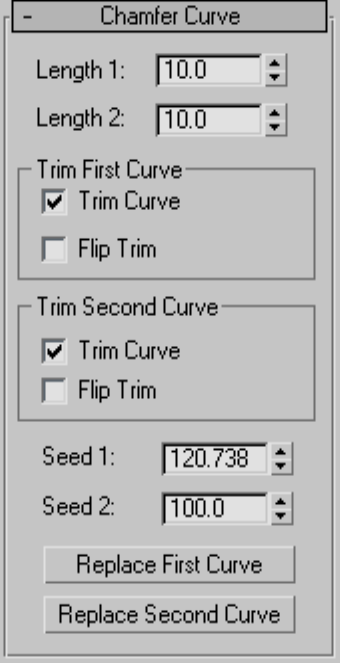
Chamfer Curve rollout (modification time)
The lengths are the distances from the intersection (or apparent intersection)
at which the chamfer segment is drawn.
Length 1 The distance along the first curve you click.
Length 2 The distance along the second curve you click.
Some length values make it impossible to construct the chamfer. If you set
the length to an invalid value, the chamfer returns to a default position and
is displayed in the error color (orange by default).
Creating and Editing NURBS Sub-Objects | 2307
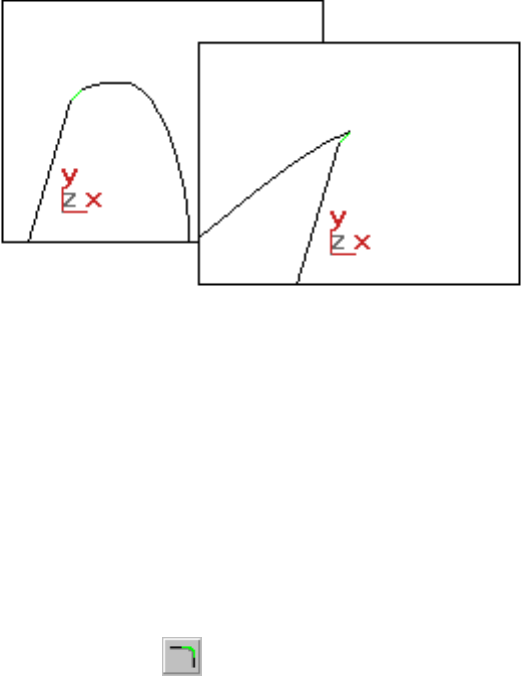
Trim First Curve and Trim Second Curve groups
These two group boxes let you control how the parent curves are trimmed.
The controls are the same in each. "First" and "second" refer to the order in
which you picked the parent curves.
Flipping the direction of a trim
Trim Curve When on (the default), trims the parent curve against the fillet
curve. When off, the parent isn't trimmed.
Flip Trim When on, trims in the opposite direction.
Seed 1 and Seed 2 Change the U location of the seed value on the first and
second curves. If there is a choice of directions, the direction indicated by the
seed points is the one used to create the chamfer.
Replace First Curve and Replace Second Curve Let you replace the parent
curves. Click the button, then click the curve to replace the original first or
second curve.
Fillet Curve
Select NURBS object. > Modify panel > Create Curves rollout > Dependent
Curves group box > Fillet button
Select NURBS object. > Modify panel > NURBS toolbox > Create Fillet Curve
button
Fillet creates a curve that is a rounded corner between two parent curves.
2308 | Chapter 10 Surface Modeling
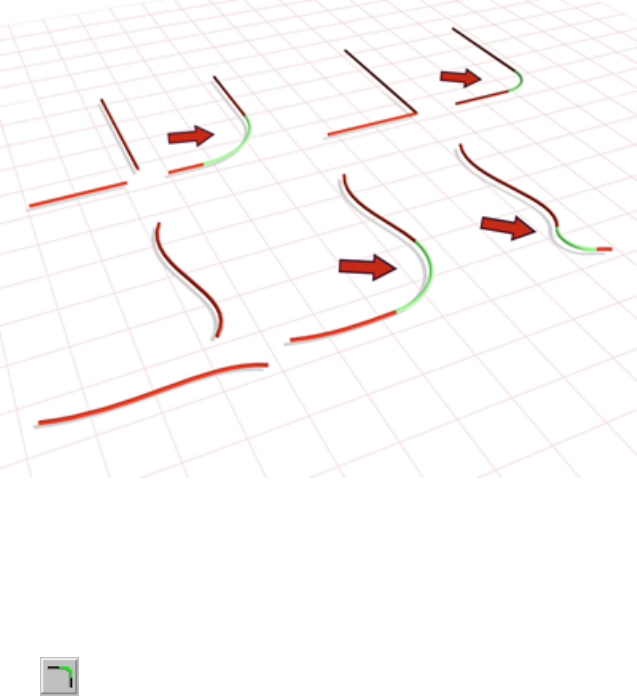
Above: Two simple fillets
Below: Flip Trim changes the direction of trimming and the shape the fillet.
Procedures
To create a fillet curve:
1 In a NURBS object that contains at least two curves, turn on Fillet.
2Click one curve near the end that you want to connect. The end that will
be connected is highlighted. Without releasing the mouse button, drag
to the end of the other curve that you want to connect. When the end
that you want to connect is highlighted, release the mouse button.
A fillet curve is created. It trims the ends of the parent curve to match
the fillet. The fillet is not necessarily placed at the endpoints of the parent
curves: placement depends on the value of the Radius parameter.
Changing the position or the curvature of either parent curve can change
the fillet as well.
The parent curves must be coplanar.
Creating and Editing NURBS Sub-Objects | 2309
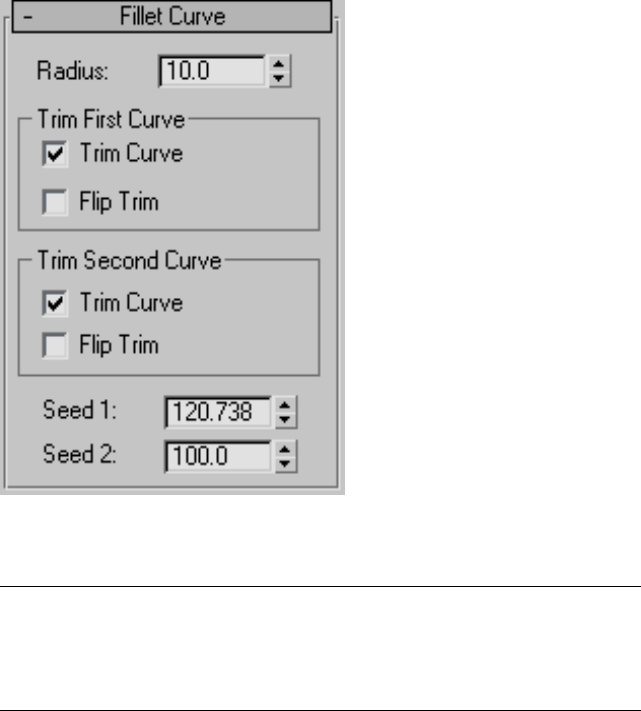
3Adjust the fillet parameters.
Interface
Fillet Curve rollout (creation time)
Radius The radius of the fillet arc in the current 3ds Max units. Default=10.0.
This parameter is animatable.
TIP If the fillet you initially create is in an error state, often this is because the
radius is not large enough to bridge the distance between the two curves.
Increasing the Radius value gives you a correct fillet. The fillet becomes an arc
displayed in the dependent object color (green by default). When the fillet is in
an error state it is displayed as a straight line in the error color (orange by default).
Trim First Curve and Trim Second Curve groups
These two group boxes let you control how the parent curves are trimmed.
The controls are the same in each. "First" and "second" refer to the order in
which you picked the parent curves.
2310 | Chapter 10 Surface Modeling
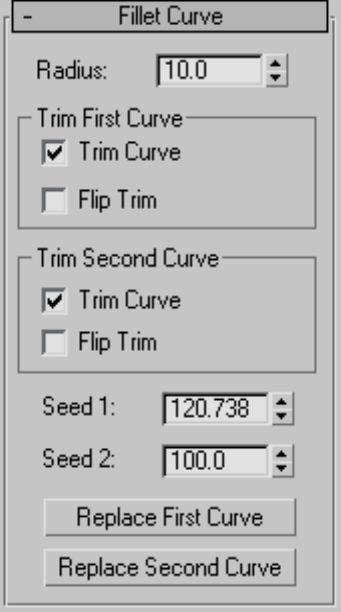
Trim Curve When on (the default), trims the parent curve against the fillet
curve. When off, the parent isn't trimmed.
Flip Trim When on, trims in the opposite direction.
Seed 1 and Seed 2 Change the U location of the seed value on the first and
second curves. If there is a choice of directions, the direction indicated by the
seed points is the one used to create the fillet.
Fillet Curve rollout (modification time)
Radius The radius of the fillet arc in the current 3ds Max units. Default=10.0.
Creating and Editing NURBS Sub-Objects | 2311
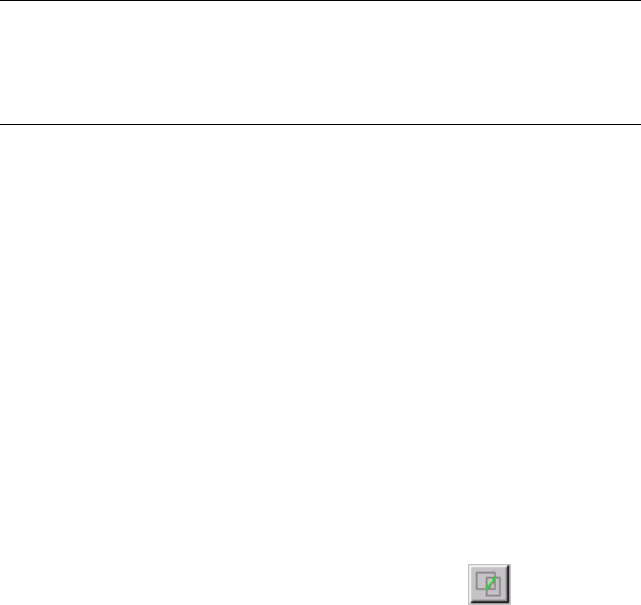
TIP If the fillet you initially create is in an error state, often this is because the
radius is not large enough to bridge the distance between the two curves.
Increasing the Radius value gives you a correct fillet. The fillet becomes an arc
displayed in the dependent object color (green by default). When the fillet is in
an error state it is displayed as a straight line in the error color (orange by default).
Trim First Curve and Trim Second Curve groups
These two group boxes let you control how the parent curves are trimmed.
The controls are the same in each. "First" and "second" refer to the order in
which you picked the parent curves.
Trim Curve When on (the default), trims the parent curve against the fillet
curve. When off, the parent isn't trimmed.
Flip Trim When on, trims in the opposite direction.
Seed 1 and Seed 2 Change the U location of the seed value on the first and
second curves. If there is a choice of directions, the direction indicated by the
seed points is the one used to create the fillet.
Replace First Curve and Replace Second Curve Let you replace the parent
curves. Click the button, then click the curve to replace the original first or
second curve.
Surface-Surface Intersection Curve
Select NURBS object. > Modify panel > Create Curves rollout > Dependent
Curves group box > Surf x Surf button
Select NURBS object. > Modify panel > NURBS toolbox > Create Surface-Surface
Intersection Curve button
2312 | Chapter 10 Surface Modeling
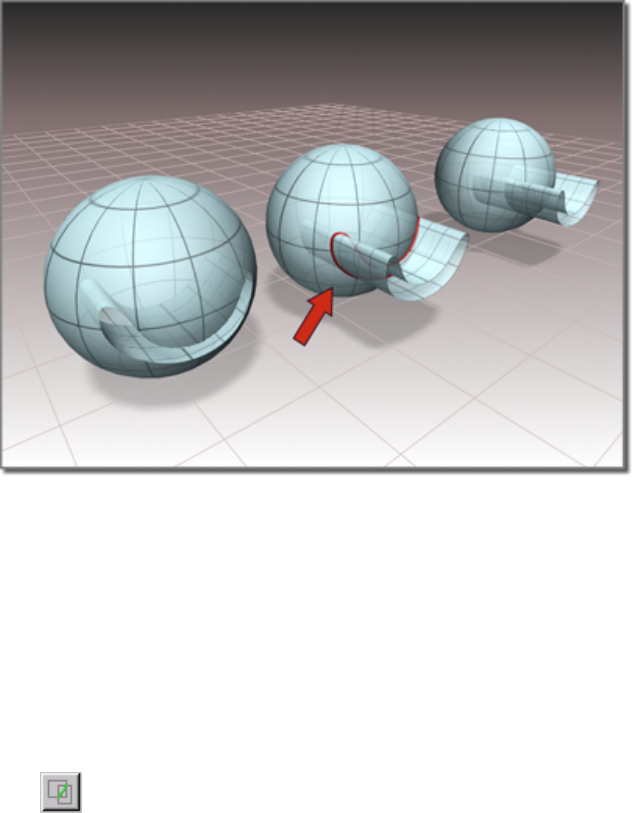
Trimming a surface with a surface-surface intersection curve
This command creates a curve that is defined by the intersection of two
surfaces. You can use surface-surface intersection curves for trimming on page
2156 .
If the surfaces intersect at two or more locations, the intersection closest to
the seed point is the one that creates the curve.
Procedures
To create a surface-surface intersection curve:
1 Turn on Create Surface-Surface Intersection Curve in the NURBS
toolbox, or Surf x Surf on the Create Curves rollout.
2Click the first surface, then the second.
If the two surfaces intersect, a curve that lies along their intersection is
created.
Creating and Editing NURBS Sub-Objects | 2313
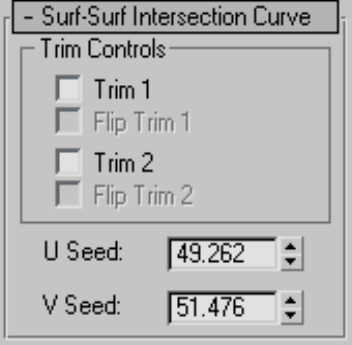
Interface
Surf-Surf Intersection Curve rollout (creation time)
Trim Controls group
Trim 1 and Trim 2 When on, trim a surface against the intersection curve.
When off, the surface isn’t trimmed. Trim 1 trims the first parent surface you
clicked, and Trim 2 trims the second parent surface.
If the intersection curve does not pass completely across a surface, trimming
is impossible, and the affected surface is displayed in the error color (orange
by default).
Flip Trim 1 and Flip Trim 2 When on, trim the associated surface in the
opposite direction.
U Seed and V Seed Change the UV location of the seed value on surface 1,
the first surface you clicked. If there is a choice of intersections, the intersection
closest to the seed point is the one used to create the curve.
2314 | Chapter 10 Surface Modeling
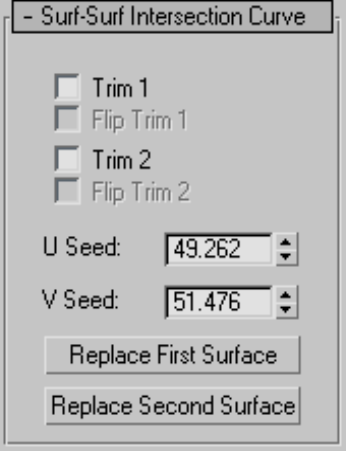
Surf-Surf Intersection Curve rollout (modification time)
Trim Controls group
Trim 1 and Trim 2 When on, trim a surface against the intersection curve.
When off, the surface isn’t trimmed. Trim 1 trims the first parent surface you
clicked, and Trim 2 trims the second parent surface.
If the intersection curve does not pass completely across a surface, trimming
is impossible, and the affected surface is displayed in the error color (orange
by default).
Flip Trim 1 and Flip Trim 2 When on, trim the associated surface in the
opposite direction.
U Seed and V Seed Change the UV location of the seed value on surface 1,
the first surface you clicked. If there is a choice of intersections, the intersection
closest to the seed point is the one used to create the curve.
Replace First Surface and Replace Second Surface Let you replace the parent
surfaces. Click a button, then click the surface to replace the original first or
second surface.
Creating and Editing NURBS Sub-Objects | 2315
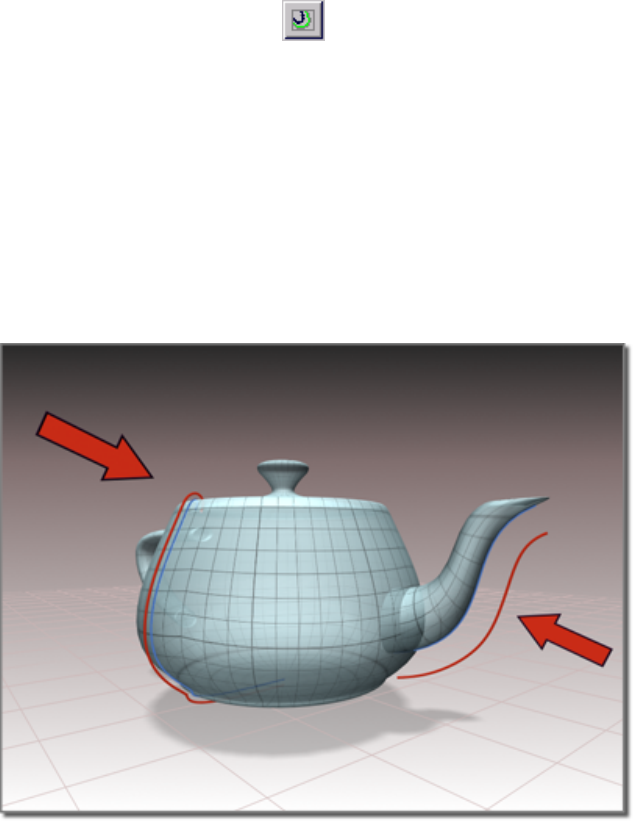
Surface Offset Curve
Select NURBS object. > Modify panel > Create Curves rollout > Dependent
Curves group box > Surf Offset button
Select NURBS object. > Modify panel > NURBS toolbox > Create Surface Offset
Curve button
This command creates a curve that is offset from a curve that lies on a surface.
In other words, the parent curve must have one of the following types:
surface-surface intersection, U iso, V iso, normal projected, vector projected,
CV curve on surface, or point curve on surface. The offset is normal to the
surface. That is, the new curve is either above or below the surface by the
offset amount.
Creating surface offset curves
2316 | Chapter 10 Surface Modeling
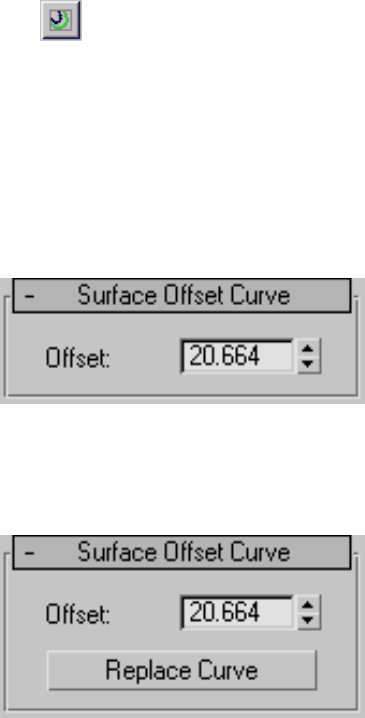
Procedures
To create a surface offset curve:
1 In a NURBS object that contains at least one NURBS surface with a
curve on it, turn on Create Surface Offset Curve in the NURBS toolbox,
or Surf Offset on the Create Curves rollout.
2Put the cursor over a curve that lies on a surface, and drag to set the offset
amount. Release the mouse button to end curve creation.
Interface
Surface Offset Curve rollout (creation time)
Offset The amount by which the curve is offset from the surface on which
the parent curve lies.
Surface Offset Curve rollout (modification time)
Offset The amount by which the curve is offset from the surface on which
the parent curve lies.
This parameter is animatable.
Replace Curve Lets you replace the parent curve. Click the button, then click
the curve to replace the original parent curve.
Creating and Editing NURBS Sub-Objects | 2317
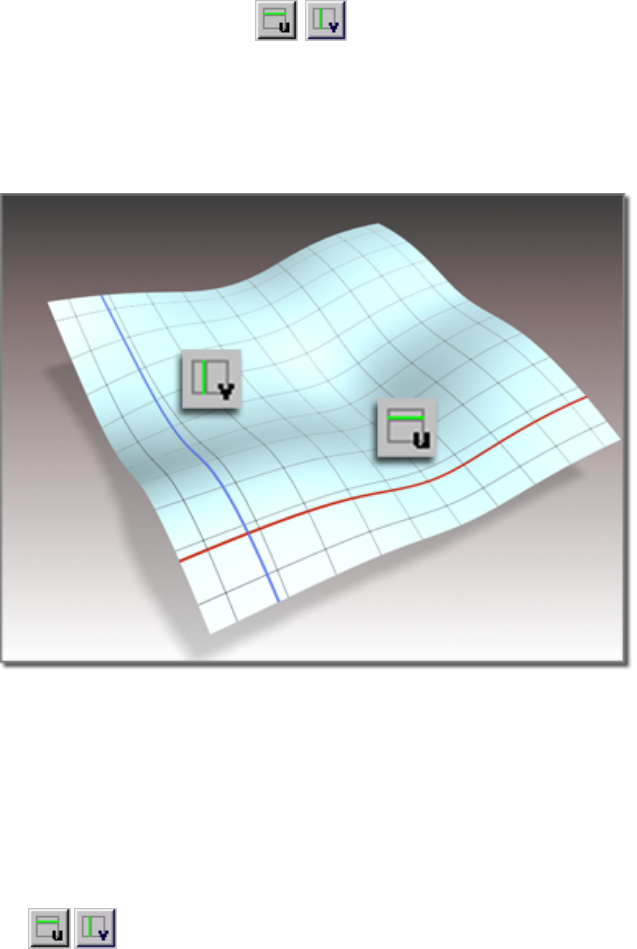
U and V Iso Curves
Select NURBS object. > Modify panel > Create Curves rollout > Dependent
Curves group box > U Iso Curve button or V Iso Curve button
Select NURBS object. > Modify panel > NURBS toolbox > Create U Iso Curve
button or Create V Iso Curve button
Iso curves in the U and V dimensions
U and V iso curves are dependent curves created from the iso (isoparametric)
lines of a NURBS surface. You can use U and V iso curves to trim surfaces on
page 2156 .
Procedures
To create an iso curve:
■ Turn on U Iso Curve or V Iso Curve, then drag over the surface.
The iso lines are highlighted in blue as you drag.
2318 | Chapter 10 Surface Modeling
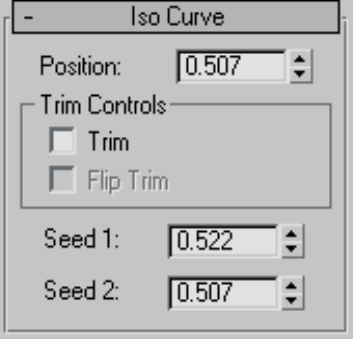
Click to create the curve from the highlighted iso line.
Interface
Iso Curve rollout (creation time)
Position Sets the iso curve's position along the U or V axis of the surface.
This parameter is animatable.
Trim Controls group
Trim When on, trims the surface against the iso curve.
Flip Trim When on, flips the direction of the trim.
Creating and Editing NURBS Sub-Objects | 2319
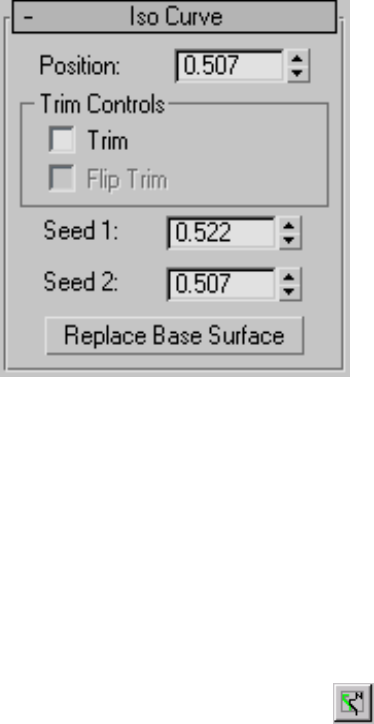
Iso Curve rollout (modification time)
Position Sets the iso curve's position along the U or V axis of the surface.
This parameter is animatable.
Trim Controls group
Trim When on, trims the surface against the iso curve.
Flip Trim When on, flips the direction of the trim.
Replace Base Surface Lets you replace the parent surface. Click the button,
then click the new surface on which to base the iso curve.
Normal Projected Curve
Select NURBS object. > Modify panel > Create Curves rollout > Dependent
Curves group box > Normal Proj. button
Select NURBS object. > Modify panel > NURBS toolbox > Create Normal
Projected Curve button
A normal projected curve lies on a surface. It is based on an original curve,
which is projected onto the surface in the direction of the surface's normals.
You can use normal projected curves for trimming on page 2156 .
2320 | Chapter 10 Surface Modeling
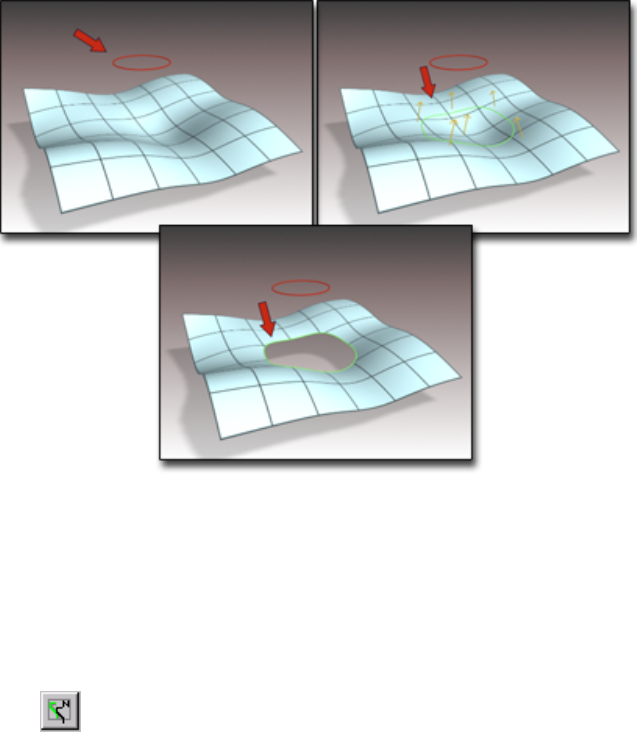
Trimming a surface with a normal projected curve
If the projection intersects the surface in two or more locations, the intersection
closest to the seed point is the one that creates the curve.
Procedures
To create a normal projected curve:
1 In a NURBS object that contains at least one surface and one curve
sub-object, turn on Normal Projected Curve in the NURBS toolbox or
Normal Proj. on the Create Curves rollout.
2Click the curve, then click the surface where you want the normal
projected curve to lie.
If the curve can be projected onto the surface in the surface's normal
direction, the projected curve is created. The original, parent curve can
go "off the edge of the surface." The projected curve is created only where
the projection and the surface intersect.
Creating and Editing NURBS Sub-Objects | 2321
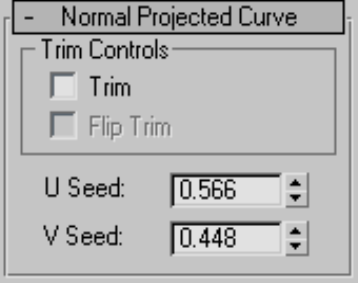
Interface
Normal Projected Curve rollout (creation time)
Trim Controls group
Trim When on, trims the surface against the curve. When off, the surface
isn’t trimmed.
If it's impossible to trim with this curve, the surface is displayed in the error
color (orange by default). For example, the curve is unusable for trimming if
it neither crosses the edge of the surface nor forms a closed loop.
Flip Trim When on, trims the surface in the opposite direction.
U Seed and V Seed Change the UV location of the seed value on the surface.
If there is a choice of projections, the projection closest to the seed point is
the one used to create the curve.
2322 | Chapter 10 Surface Modeling
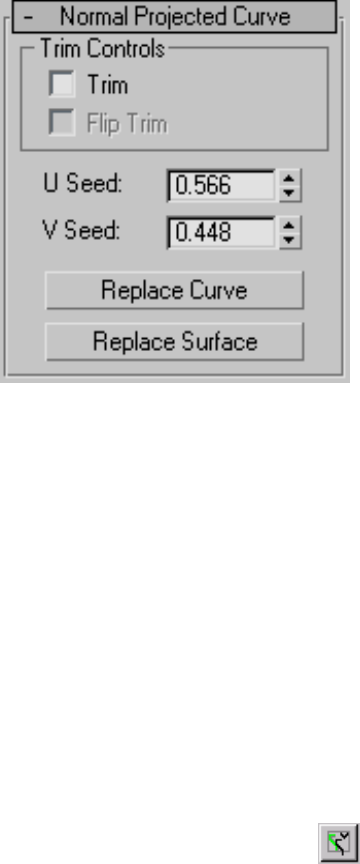
Normal Projected Curve rollout (modification time)
Trim Controls group
Trim When on, trims the surface against the curve. When off, the surface
isn’t trimmed.
If it's impossible to trim with this curve, the surface is displayed in the error
color (orange by default). For example, the curve is unusable for trimming if
it neither crosses the edge of the surface nor forms a closed loop.
Flip Trim When on, trims the surface in the opposite direction.
U Seed and V Seed Change the UV location of the seed value on the surface.
If there is a choice of projections, the projection closest to the seed point is
the one used to create the curve.
Replace Curve and Replace Surface Let you replace the parent sub-objects.
Click a button, then click a curve or surface to replace the original parent
object.
Vector Projected Curve
Select NURBS object. > Modify panel > Create Curves rollout > Dependent
Curves group box > Vector Proj. button
Creating and Editing NURBS Sub-Objects | 2323
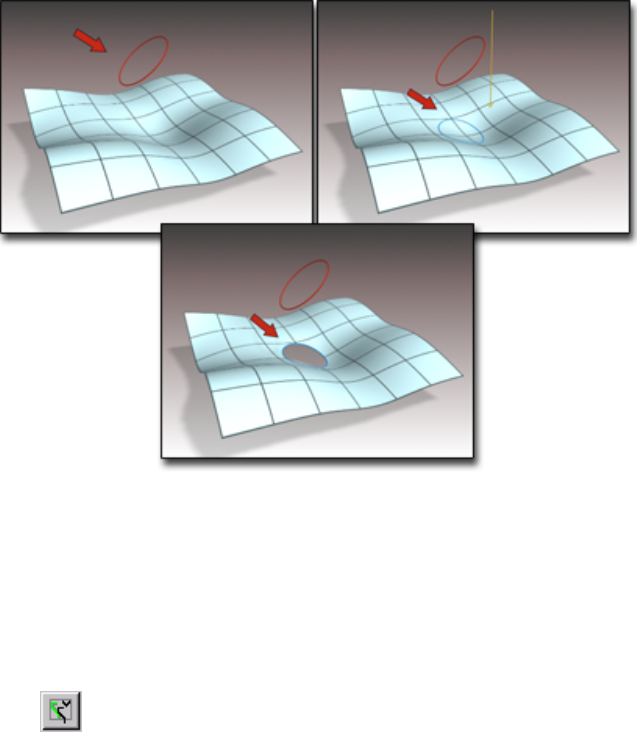
Select NURBS object. > Modify panel > NURBS toolbox > Create Vector
Projected Curve button
A Vector Projected curve lies on a surface. This is almost the same as a Normal
Projected curve, except that the projection from the original curve to the
surface is in the direction of a vector that you can control.
You can use vector projected curves for trimming on page 2156 .
Trimming a surface with a vector projected curve
If the projection intersects the surface in two or more locations, the intersection
closest to the seed point is the one that creates the curve.
Procedures
To create a vector projected curve:
1 In a NURBS object that contains at least one surface and one curve
sub-object, click to turn on Vector Projected Curve in the NURBS toolbox
or Vector Proj. in the Create Curves rollout.
2324 | Chapter 10 Surface Modeling
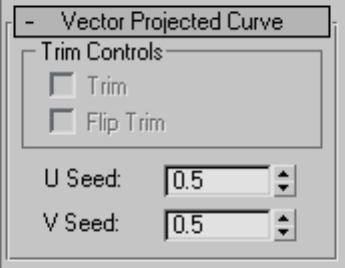
2Click the curve, then the surface where you want the vector projection
curve to lie.
The initial vector direction is in the view direction. That is, the vector
points away from you as you look at the viewport. If the curve can be
projected onto the surface in this direction, the projection curve is created.
The original, parent curve can go "off the edge of the surface." The
projection curve is created only where the projection and the surface
intersect.
Interface
In viewports a gizmo (yellow by default) indicates the projection axis.
Transforming the gizmo changes the projection onto the surface. Rotating
the gizmo is the most useful transform. You can use rotation to adjust the
distortion caused by projection.
Vector Projected Curve rollout (creation time)
Trim Controls group
Trim When on, trims the surface against the curve. When off, the surface
isn’t trimmed.
If it's impossible to trim with this curve, the surface is displayed in the error
color (orange by default). For example, the curve is unusable for trimming if
it neither crosses the edge of the surface nor forms a closed loop.
Flip Trim When on, trims the surface in the opposite direction.
Creating and Editing NURBS Sub-Objects | 2325
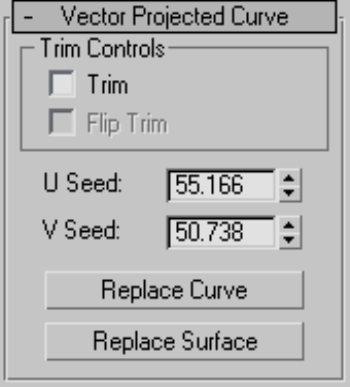
U Seed and V Seed Change the UV location of the seed value on the surface.
If there is a choice of projections, the projection closest to the seed point is
the one used to create the curve.
Vector Projected Curve rollout (modification time)
Trim Controls group
Trim When on, trims the surface against the curve. When off, the surface
isn’t trimmed.
If it's impossible to trim with this curve, the surface is displayed in the error
color (orange by default). For example, the curve is unusable for trimming if
it neither crosses the edge of the surface nor forms a closed loop.
Flip Trim When on, trims the surface in the opposite direction.
U Seed and V Seed Change the UV location of the seed value on the surface.
If there is a choice of projections, the projection closest to the seed point is
the one used to create the curve.
Replace Curve and Replace Surface Let you replace the parent sub-objects.
Click a button, then click a curve or surface to replace the original parent
object.
2326 | Chapter 10 Surface Modeling
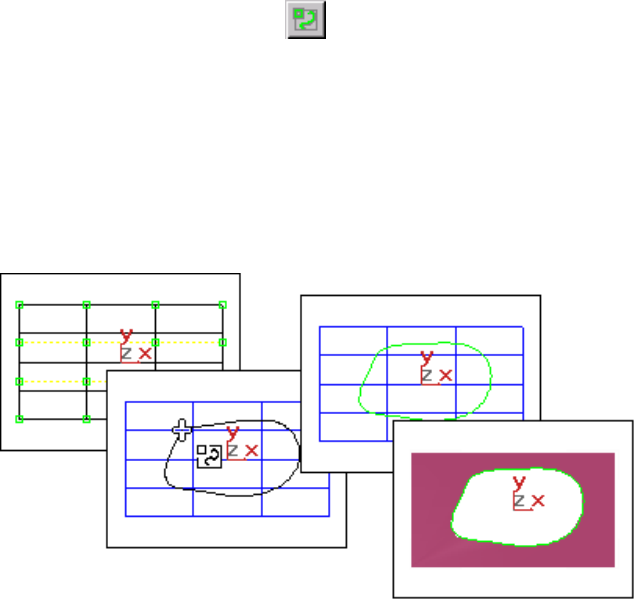
CV Curve on Surface
Select NURBS object. > Modify panel > Create Curves rollout > Dependent
Curves group box > CV on Surf button
Select NURBS object. > Modify panel > NURBS toolbox > Create CV Curve on
Surface button
A CV curve on surface is similar to a plain CV curve, but it lies on a surface.
You create it by drawing rather than projecting from a different curve. You
can use this curve type for trimming on page 2156 the surface on which it lies.
Trimming a surface with a CV curve on surface
There are two methods for drawing and editing curves on surfaces: drawing
in a viewport, or using the Edit Curve on Surface dialog. The choice is useful
because you draw in two dimensions, with a mouse or other pointing device,
while the curve on a surface can exist in three dimensions. The more complex
the 3D surface, the more effort it can require to create and edit a curve on a
surface.
Visual feedback can help you draw the curve. The point whose surface you
first click is shown as a blue square, and the surface's minimum UV point is
shown as a plus sign (+). As you draw the curve, it is displayed interactively
in viewports.
Creating and Editing NURBS Sub-Objects | 2327

Drawing in a Viewport
When you click to position a CV, the click is projected in the viewport's Z
dimension. That is, your click is projected "through the screen" and onto the
surface. This is a straightforward way to create a curve on a surface if the
portion of the surface where the curve will lie is clearly visible in the viewport.
However, this method doesn't let you place CVs on surface locations that are
not visible in the viewport (they are on back faces, lie behind other geometry,
and so on).
Using the Edit Curve on Surface Dialog
The Edit Curve on Surface dialog on page 2450 lets you edit curves on surfaces
as you edit regular curves in a viewport. The main part of the dialog is a
two-dimensional view of the surface. The controls provide typical curve editing
functions. While you are creating a CV curve on surface, the 2D View toggle
controls display of the Edit Curve on Surface dialog.
You can edit the CVs in CV curves on surfaces at the Curve CV sub-object
level on page 2238 , as you edit other kinds of curve CVs. You can transform
CVs in CV curves on surfaces, but you can't move the CVs off the surface.
Using the Curve CV sub-object level is an alternative to editing these CVs by
using the Edit Curve on Surface dialog.
Procedures
To create a CV curve on surface:
1 In a NURBS object that contains at least one surface, turn on Create
CV Curve on Surface in the NURBS toolbox, or CV on Surf on the Create
Curves rollout.
2Do one of the following:
■Draw the curve in the viewport, using the mouse above the surface.
■Turn on 2D View. This displays an Edit Curve on Surface dialog, which
lets you create the curve in a two-dimensional (UV) representation of
the surface.
3Right-click to end curve creation.
2328 | Chapter 10 Surface Modeling
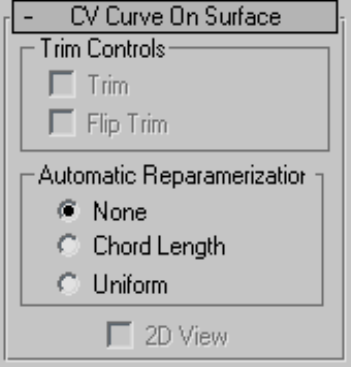
Interface
CV Curve on Surface rollout (creation time)
Trim Controls group
Trim When on, trims the surface against the curve. When off, the surface
isn’t trimmed.
If it's impossible to trim with this curve, the surface is displayed in the error
color (orange by default). For example, the curve is unusable for trimming if
it doesn't form a closed loop.
Flip Trim When on, trims the surface in the opposite direction.
Automatic Reparameterization group
The radio buttons in this group box let you choose automatic
reparameterization. With reparameterization, the curve maintains its
parameterization as you edit it. Without reparameterization, the curve's
parameterization doesn't change as you edit it, and can become irregular.
None Do not reparameterize.
Chord Length Chooses the chord-length algorithm for reparameterization.
Chord-length reparameterization spaces knots (in parameter space on page
7882 ) based on the square root of the length of each curve segment.
Creating and Editing NURBS Sub-Objects | 2329
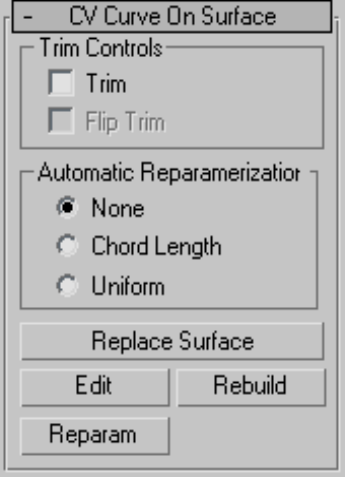
Chord-length reparameterization is usually the best choice.
Uniform Spaces the knots uniformly.
A uniform knot vector has the advantage that the curve will change only
locally when you edit it. With the other two forms of parameterization, moving
any CV can change the entire curve.
2D View When on, displays the Edit Curve on Surface dialog on page 2450 ,
which lets you create the curve in a two-dimensional (UV) representation of
the surface.
CV Curve on Surface rollout (modification time)
Trim Controls group
Trim When on, trims the surface against the curve. When off, the surface
isn’t trimmed.
If it's impossible to trim with this curve, the surface is displayed in the error
color (orange by default). For example, the curve is unusable for trimming if
it doesn't form a closed loop.
Flip Trim When on, trims the surface in the opposite direction.
2330 | Chapter 10 Surface Modeling

Automatic Reparameterization group
The radio buttons in this group box let you choose automatic
reparameterization. With reparameterization, the curve maintains its
parameterization as you edit it. Without reparameterization, the curve's
parameterization doesn't change as you edit it, and can become irregular.
None Do not reparameterize.
Chord Length Chooses the chord-length algorithm for reparameterization.
Chord-length reparameterization spaces knots (in parameter space on page
7882 ) based on the square root of the length of each curve segment.
Chord-length reparameterization is usually the best choice.
Uniform Spaces the knots uniformly.
A uniform knot vector has the advantage that the curve will change only
locally when you edit it. With the other two forms of parameterization, moving
any CV can change the entire curve.
Replace Surface Lets you replace the parent surface. Click a button, then
click a surface to replace the original parent surface.
Edit Click to display the Edit Curve on Surface dialog on page 2450 , which
lets you edit the curve in a two-dimensional (UV) representation of the surface.
To edit multiple curves on a surface, select more than one CV curve sub-object
on the same surface, then click Edit.
Rebuild Displays the Rebuild CV Curve dialog on page 2463 to let you rebuild
the CV curve on surface.
Reparam Displays the Reparameterize dialog on page 2465 to let you
reparameterize the CV curve on surface.
Point Curve on Surface
Select NURBS object. > Modify panel > Create Curves rollout > Dependent
Curves group box > Point on Surf button
Select NURBS object. > Modify panel > NURBS toolbox > Create Point Curve
on Surface button
Creating and Editing NURBS Sub-Objects | 2331
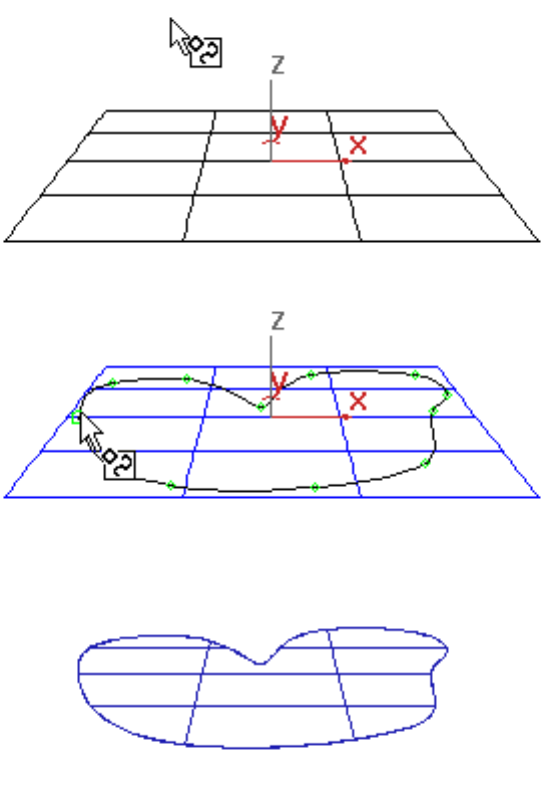
A point curve on surface is similar to a plain point curve, but it lies on a surface.
You create it by drawing rather than projecting from a different curve. You
can use this curve type for trimming on page 2156 the surface on which it lies.
Trimming a surface with a point curve on surface
There are two methods for drawing and editing curves on surfaces: drawing
in a viewport, or using the Edit Curve on Surface dialog. The choice is useful
because you draw in two dimensions, with a mouse or other pointing device,
2332 | Chapter 10 Surface Modeling

while the curve on a surface can exist in three dimensions. The more complex
the 3D surface, the more effort it can require to create and edit a curve on a
surface.
Visual feedback can help you draw the curve. The point whose surface you
first click is shown as a blue square, and the surface's minimum UV point is
shown as a plus sign (+). As you draw the curve, it is displayed interactively
in viewports.
Drawing in a Viewport
When you click to position a point, the click is projected in the viewport's Z
dimension. That is, your click is projected "through the screen" and onto the
surface. This is a straightforward way to create a curve on a surface if the
portion of the surface where the curve will lie is clearly visible in the viewport.
However, this method doesn't let you place points on surface locations that
are not visible in the viewport (they are on back faces, lie behind other
geometry, and so on).
Using the Edit Curve on Surface Dialog
The Edit Curve on Surface dialog on page 2450 lets you edit curves on surfaces
as you edit regular curves in a viewport. The main part of the dialog is a
two-dimensional view of the surface. The controls provide typical curve editing
functions. While you are creating a point curve on surface, the 2D View toggle
controls display of the Edit Curve on Surface dialog.
You can edit the points in point curves on surfaces at the Point sub-object
level on page 2231 , as you edit other kinds of points. You can transform points
in point curves on surfaces, but you can't move the points off the surface.
Using the Point sub-object level is an alternative to editing these points by
using the Edit Curve on Surface dialog.
Procedures
To create a point curve on surface:
1 In a NURBS object that contains at least one surface, turn on Create
Point Curve on Surface in the NURBS toolbox, or Point on Surf on the
Create Curves rollout.
Creating and Editing NURBS Sub-Objects | 2333
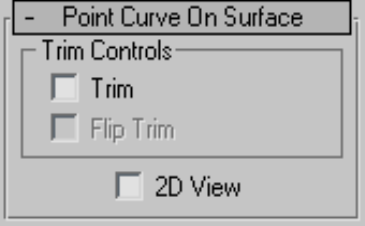
2Do one of the following:
■Draw the curve in the viewport, using the mouse above the surface.
■Turn on 2D View. This displays an Edit Curve on Surface dialog, which
lets you create the curve in a two-dimensional (UV) representation of
the surface.
3Right-click to end curve creation.
Interface
Point curves on surfaces have point sub-objects that you can transform and
edit in viewports as you do with plain point curves.
(There is no special Move Surface Points button as there was prior to 3ds Max
3.)
Point Curve on Surface rollout (creation time)
Trim Controls group
Trim When on, trims the surface against the curve. When off, the surface
isn’t trimmed.
If it's impossible to trim with this curve, the surface is displayed in the error
color (orange by default). For example, the curve is unusable for trimming if
it doesn't form a closed loop.
Flip Trim When on, trims the surface in the opposite direction.
2D View When on, displays the Edit Curve on Surface dialog on page 2450 ,
which lets you create the curve in a two-dimensional (UV) representation of
the surface.
2334 | Chapter 10 Surface Modeling
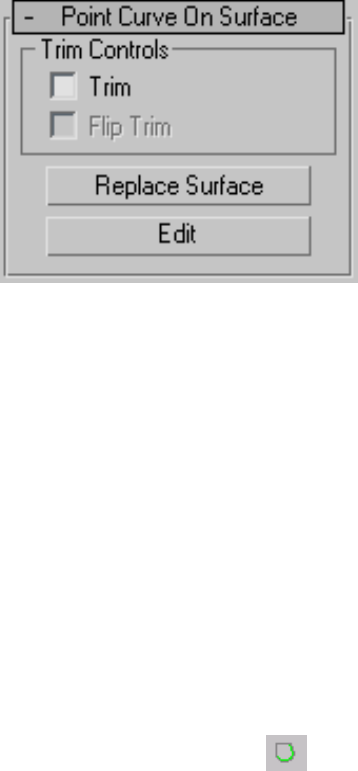
Point Curve on Surface rollout (modification time)
Trim Controls group
Trim When on, trims the surface against the curve. When off, the surface
isn’t trimmed.
If it's impossible to trim with this curve, the surface is displayed in the error
color (orange by default). For example, the curve is unusable for trimming if
it doesn't form a closed loop.
Flip Trim When on, trims the surface in the opposite direction.
Replace Surface Lets you replace the parent surface. Click a button, then
click a surface to replace the original parent surface.
Edit Click to display the Edit Curve on Surface dialog on page 2450 , which
lets you edit the curve in a two-dimensional (UV) representation of the surface.
To edit multiple curves on a surface, select more than one point curve
sub-object on the same surface, then click Edit.
Surface Edge Curve
Select NURBS object. > Modify panel > Create Curves rollout > Dependent
Curves group box > Surf Edge button
Select NURBS object. > Modify panel > NURBS toolbox > Create Surface Edge
Curve button
Creating and Editing NURBS Sub-Objects | 2335
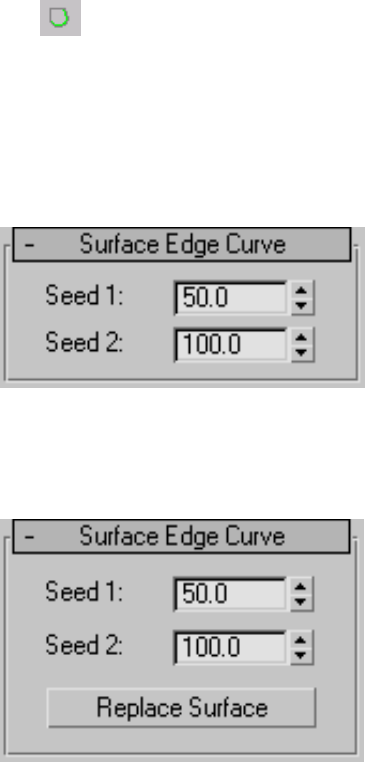
A surface edge curve is a dependent curve type that lies on the boundary of
the surface. It can be the original boundary of the surface, or a trim edge.
Procedures
To create a surface edge curve:
1 Turn on Surf Edge.
2As you move the mouse in the scene, NURBS surface edges are highlighted
in blue. Click the edge where you want to create the curve.
Interface
Surface Edge Curve rollout (creation time)
Seed 1 and Seed 2 The curve resides on the edge closest to the two seed
values. Adjust the seed values to change the edge on which the curve resides.
Surface Edge Curve rollout (modification time)
Seed 1 and Seed 2 The curve resides on the edge closest to the two seed
values. Adjust the seed values to change the edge on which the curve resides.
2336 | Chapter 10 Surface Modeling
Replace Surface This lets you replace the parent surface. Click a button,
then click a surface to replace the original parent surface.
Creating Surface Sub-Objects
Select NURBS object. > Modify panel > Create Surfaces rollout
Select NURBS object. > NURBS toolbox
Keyboard > Ctrl+T to toggle NURBS toolbox display (Keyboard Shortcut
Override Toggle must be on.)
Surface sub-objects are either independent point and CV surfaces (like the
top-level point and CV surfaces described in Point Surface and CV Surface),
or they are dependent surfaces. Dependent surfaces are surface sub-objects
whose geometry depends on other surfaces or curves in the NURBS model.
When you change the geometry of the original, parent surface or curve, the
dependent surface changes as well.
You create surface sub-objects using the Create Surfaces rollout on the Modify
panel for a NURBS surface, or using the NURBS toolbox on page 2162 .
Creating and Editing NURBS Sub-Objects | 2337
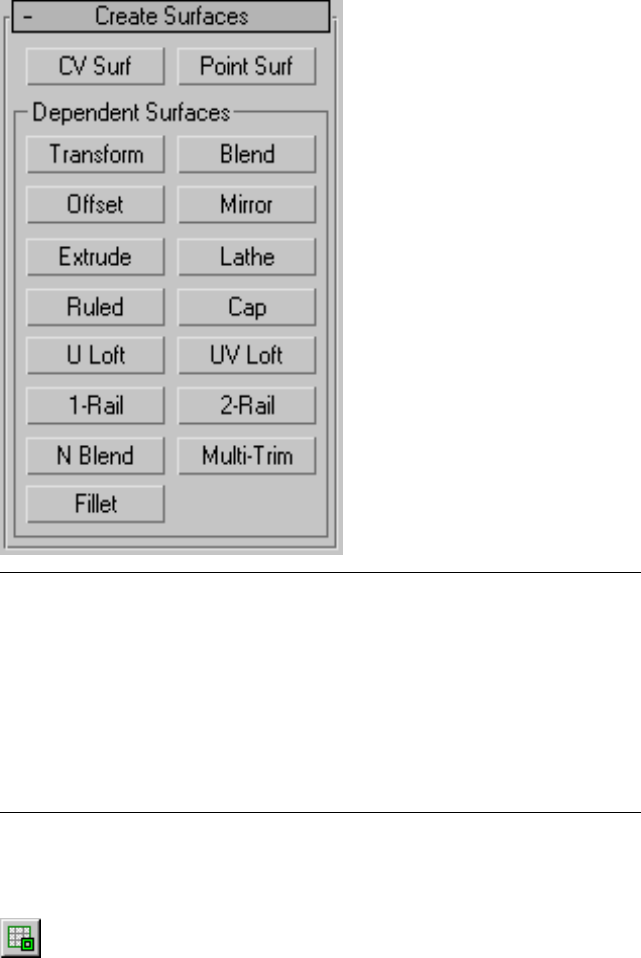
TIP Lathe and extrude surface sub-objects can be based on only a single curve. If
you have dependent curves and want to use the set of curves (for example, two
parents and a fillet between them) as the basis of an extrude or lathe surface, first
go to the Curve sub-object level and use Join to connect the curves.
Creation operations for dependent sub-objects require that you select one or
more parent objects. In general, you can click and drag, or click and then click
again. You can also use the H keyboard shortcut to open a Pick Object version
of the Selection Floater on page 171 for choosing the parent. (The Keyboard
Shortcut Override Toggle on page 7646 must be on for H to work this way.)
Toolbox Buttons for Creating Surfaces
These are the toolbox buttons for creating surface sub-objects:
Create an independent CV surface sub-object on page 2340 .
2338 | Chapter 10 Surface Modeling

Create an independent point surface sub-object on page 2344 .
Create a dependent transform surface on page 2346 .
Create a dependent blend surface on page 2348 .
Create a dependent offset surface on page 2355 .
Create a dependent mirror surface on page 2358 .
Create a dependent extrude surface on page 2362 .
Create a dependent lathe surface on page 2365 .
Create a dependent ruled surface on page 2374 .
Create a dependent cap surface on page 2377 .
Create a dependent U loft surface on page 2380 .
Create a dependent UV loft surface on page 2390 .
Create a dependent 1-rail sweep surface on page 2397 .
Create a dependent 2-rail sweep surface on page 2407 .
Create a dependent multisided blend surface on page 2417 .
Create a dependent multicurve trimmed surface on page 2418 .
Create a dependent fillet surface on page 2423 .
Creating and Editing NURBS Sub-Objects | 2339
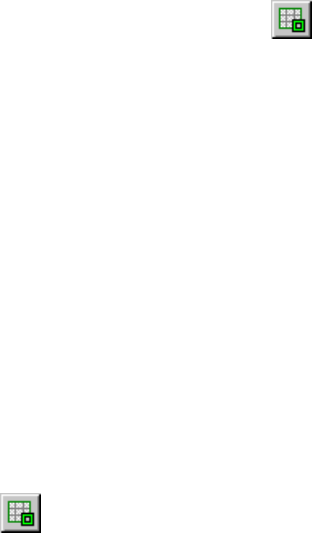
CV Surface Sub-Object
Select NURBS object. > Modify panel > Create Surfaces rollout > CV Surf
Select NURBS object. > Modify panel > NURBS toolbox > Create CV Surface
button
Select NURBS object. > Modify panel > Right-click a viewport. > Tools 2
(lower-left) quadrant > Create CV Surface
CV surface sub-objects are similar to object-level CV surfaces on page 2195 .
See also:
■Editing Surface Sub-Objects on page 2264
■Surface Approximation on page 2469
Procedures
To create a CV surface sub-object:
1 In a NURBS object, turn on CV Surf on the Create Surfaces rollout
or Create CV Surface in the toolbox.
2In a viewport, drag to specify the initial area of the CV surface.
3Adjust the CV surface's creation parameters.
Interface
The parameters that appear when you create a CV surface sub-object differ
from those you see when you modify it as a sub-object.
2340 | Chapter 10 Surface Modeling
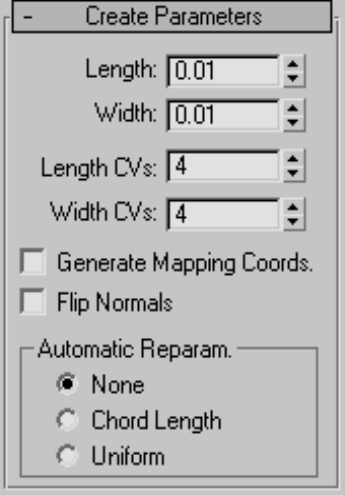
CV Surface rollout (creation time)
Length The length of the surface in current 3ds Max units.
Width The width of the surface in current 3ds Max units.
Length Points The number of points along the length of the surface. In other
words, the initial number of point columns in the surface. Range=2 to 50.
Default=4.
Width Points The number of points along the width of the surface. In other
words, the initial number of point rows in the surface. Range=2 to 50.
Default=4.
Generate Mapping Coordinates Generates mapping coordinates so you can
apply mapped materials to the surface.
Flip Normals Turn on to reverse the direction of the surface normals.
Automatic Reparameterization group
The radio buttons in this group box let you choose automatic
reparameterization. With reparameterization, the surface maintains its
Creating and Editing NURBS Sub-Objects | 2341
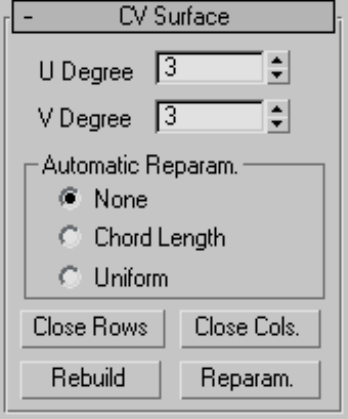
parameterization as you edit it. Without reparameterization, the surface's
parameterization doesn't change as you edit it, and can become irregular.
None Do not reparameterize.
Chord Length Chooses the chord-length algorithm for reparameterization.
Chord-length reparameterization spaces knots (in parameter space on page
7882 ) based on the square root of the length of each curve segment.
Chord-length reparameterization is usually the best choice.
Uniform Spaces the knots uniformly.
A uniform knot vector has the advantage that the surface will change only
locally when you edit it. With the other two forms of parameterization, moving
any CV can change the entire surface.
CV Surface rollout (modification time)
U Degree and V Degree Let you set the degree of the surface in either the
U or V dimension. The higher the degree value, the greater the continuity.
The lower the degree, the more discontinuous the surface segments become.
The degree can't be less than one or greater than the number allowed by the
number of CVs in the specified dimension. Degree 3 is adequate to represent
continuous surfaces, and is stable and well behaved. Default=3.
2342 | Chapter 10 Surface Modeling

Setting the degree greater than 3 isn't recommended, because higher degrees
are slower to calculate and less stable numerically. Higher degrees are supported
primarily to be compatible with models created using other surface modeling
programs.
The number of CVs in a given dimension must be at least one greater than
that dimension's degree.
Automatic Reparameterization group
The radio buttons in this group box let you choose automatic
reparameterization. With reparameterization, the surface maintains its
parameterization as you edit it. Without reparameterization, the surface's
parameterization doesn't change as you edit it, and can become irregular.
None Do not reparameterize.
Chord Length Chooses the chord-length algorithm for reparameterization.
Chord-length reparameterization spaces knots (in parameter space on page
7882 ) based on the square root of the length of each curve segment.
Chord-length reparameterization is usually the best choice.
Uniform Spaces the knots uniformly.
A uniform knot vector has the advantage that the surface will change only
locally when you edit it. With the other two forms of parameterization, moving
any CV can change the entire surface.
The close controls let you close a surface. They appear on the Point Surface
rollout while an independent point surface sub-object is selected. They have
no effect if the surface is already closed in that direction.
Close Rows Closes the surface by joining the ends of its rows.
Close Cols. Closes the surface by joining the ends of its columns.
Rebuild Displays the Rebuild CV Surface dialog on page 2464 , which lets you
specify how to rebuild the surface. Rebuilding the surface can change its
appearance.
Reparameterize Displays the Reparameterize dialog on page 2465 .
Reparameterizing a surface changes the surface's parameter space on page 7882
to provide a better relation between control point locations and the shape of
the surface.
TIP It is a good idea to reparameterize after you have added CVs to the surface
by refining or inserting.
Creating and Editing NURBS Sub-Objects | 2343
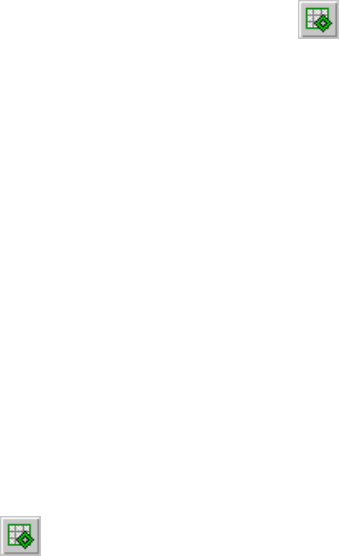
Point Surface Sub-Object
Select NURBS object. > Modify panel > Create Surfaces rollout > Point Surf
Select NURBS object. > Modify panel > NURBS toolbox > Create Point Surface
button
Select NURBS object. > Modify panel > Right-click a viewport. > Tools 2
(lower-left) quadrant > Create Point Surface
Point surface sub-objects are similar to object-level point surfaces on page 2192
. The points are constrained to lie on the surface.
See also:
■Editing Surface Sub-Objects on page 2264
■Surface Approximation on page 2469
Procedures
To create a point surface sub-object:
1 In a NURBS object, turn on Point Surf on the Create Surfaces rollout
or Create Point Surface in the toolbox.
2In a viewport, drag to specify the initial area of the point surface.
3Adjust the point surface's creation parameters.
Interface
The parameters that appear when you create a point surface sub-object differ
from those you see when you modify it as a sub-object.
2344 | Chapter 10 Surface Modeling
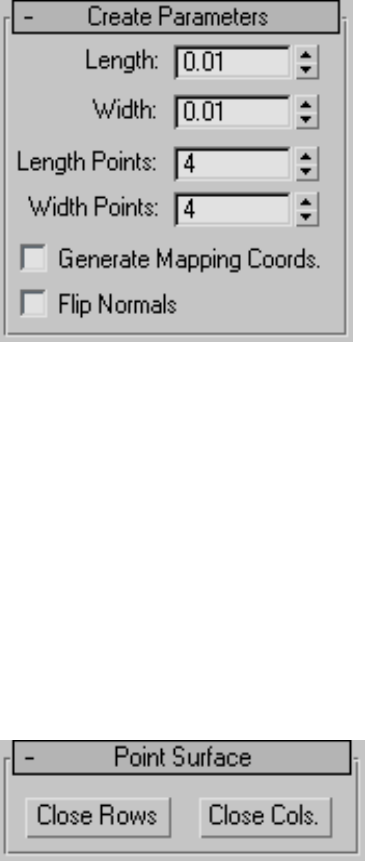
Point Surface rollout (creation time)
Length The length of the surface in current 3ds Max units.
Width The width of the surface in current 3ds Max units.
Length Points The number of points along the length of the surface. In other
words, the initial number of point columns in the surface. Range=2 to 50.
Default=4.
Width Points The number of points along the width of the surface. In other
words, the initial number of point rows in the surface. Range=2 to 50.
Default=4.
Generate Mapping Coordinates Generates mapping coordinates so you can
apply mapped materials to the surface.
Flip Normals Turn on to reverse the direction of the surface normals.
Point Surface rollout (modification time)
The close controls let you close a surface. They appear on the Point Surface
rollout while an independent point surface sub-object is selected. They have
no effect if the surface is already closed in that direction.
Creating and Editing NURBS Sub-Objects | 2345
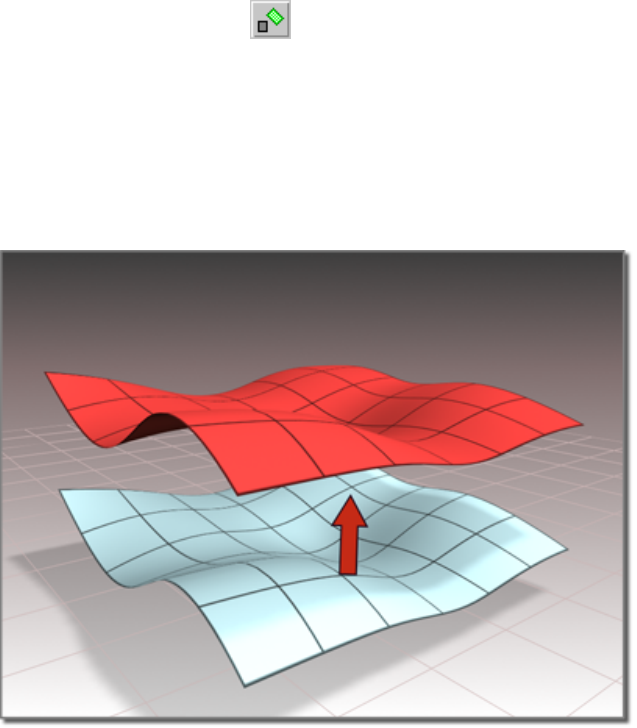
Close Rows Closes the surface by joining the ends of its rows.
Close Cols. Closes the surface by joining the ends of its columns.
Transform Surface
Select NURBS object. > Modify panel > Create Surfaces rollout Dependent
Surfaces group box > Transform
Select NURBS object. > Modify panel > NURBS toolbox > Create Transform
Surface button
A transform surface is a copy of the original surface with a different position,
rotation, or scale.
Surface created as a transform
2346 | Chapter 10 Surface Modeling
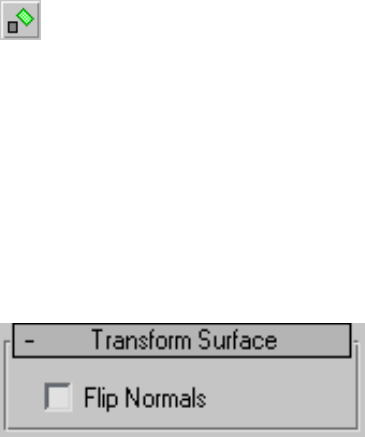
Procedures
To create a transform surface:
■ In a NURBS object that contains at least one surface, turn on
Transform.
To move the transform surface, click and drag the surface you want to
duplicate. To rotate or scale the transform surface, click the parent surface,
click to turn on Sub-Object on the Modifier Stack rollout, choose Surface
from the drop-down list, and then use a transform to rotate or scale the
transform surface.
When you use Move to create the transform surface, it simply copies the
parent. (It doesn't exaggerate curvature as an offset surface does.)
Axis constraints don't apply to the creation of transform surfaces. You can
click to create the surface in place; then once it is created, transform it
using constraints.
The Flip Normals control lets you flip the surface normals at creation time.
(After creation, you can flip normals using controls on the Surface Common
rollout.)
You can later transform the transform surface as a surface sub-object, and you
can animate surface sub-object transforms.
Interface
Creation time
At creation time, transform surfaces have no parameters.
Creating and Editing NURBS Sub-Objects | 2347
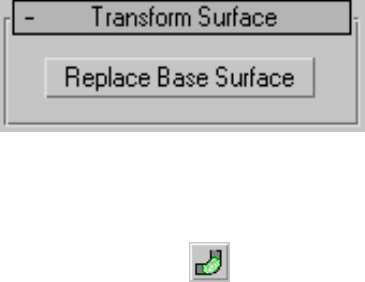
Transform Surface rollout (modification time)
Replace Base Surface Lets you replace the parent surface. Click the button,
then click the surface to replace the original surface.
Blend Surface
Select NURBS object. > Modify panel > Create Surfaces rollout > Dependent
Surfaces group box > Blend
Select NURBS object. > Modify panel > NURBS toolbox > Create Blend Surface
button
A blend surface connects one surface to another, blending the curvature of
the parent surfaces to create a smooth surface between them. You can also
blend from a surface to a curve, or from a curve to a curve.
2348 | Chapter 10 Surface Modeling
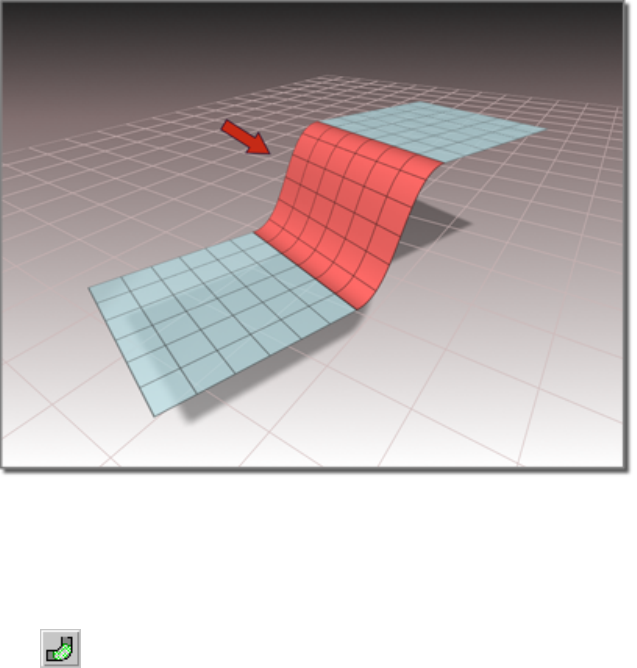
Blend surface connecting two other surfaces
Procedures
To create a blend surface:
1 In a NURBS object that contains two surfaces, two curves, or a surface
and a curve, turn on Blend.
2Click one surface near the edge that you want to connect. The edge that
will be connected is highlighted in blue. Drag to choose the other edge
you want to connect. When the edge you want is highlighted, click and
then drag to the other surface. The edge of the other surface is also
highlighted in blue. Drag on the other surface to choose the edge to
connect, and then release the mouse button to create the blend surface.
The surface that owns the highlighted edge is highlighted in yellow, to
help you distinguish which edge you are choosing when two surfaces
have coincident edges.
The blend surface is created. Changing the position or the curvature of
either parent surface will change the blend surface as well.
Creating and Editing NURBS Sub-Objects | 2349
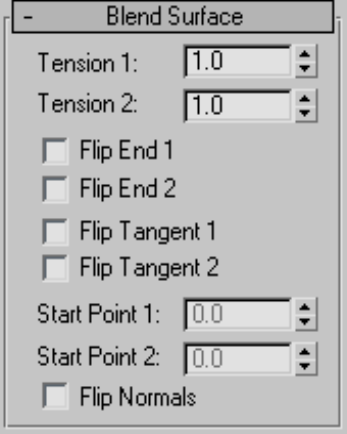
3Adjust the blend parameters.
Interface
While a blend surface sub-object is selected, a rollout with the blend parameters
is displayed at the bottom of the Modify panel.
Blend Surface rollout (creation time)
"Tension" affects the tangent between a parent surface and the blend surface.
The greater the tension value, the more closely the tangent parallels the parent
surface, and the smoother the transition. The lower the tension, the greater
the tangent angle and the sharper the transition between parent and blend.
Tension 1 Controls tension at the edge of the first surface you clicked. This
value has no effect if the edge is a curve.
Tension 2 Controls tension at the edge of the second surface you clicked.
This value has no effect if the edge is a curve.
2350 | Chapter 10 Surface Modeling
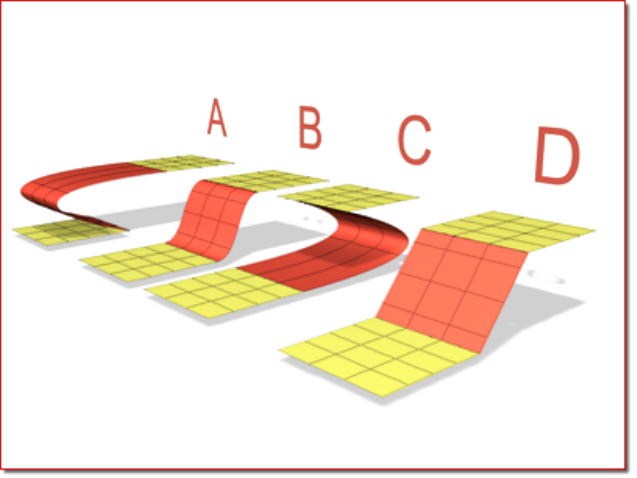
A. Tension 1=0, Tension 2=10
B. Tension 1=1, Tension 2=1
C. Tension 1=10, Tension 2=0
D. Tension 1=0, Tension 2=0
Flip End 1 and Flip End 2 Flip one of the normals used to construct the blend.
A blend surface is created using the normals of the parent surfaces. If the two
parents have opposing normals, or if a curve has the opposite direction, the
blend surface can be shaped like a bow tie. To correct the situation, use Flip
End 1 or Flip End 2 to construct the blend using a normal opposite the
corresponding parent surface's normal.
Creating and Editing NURBS Sub-Objects | 2351
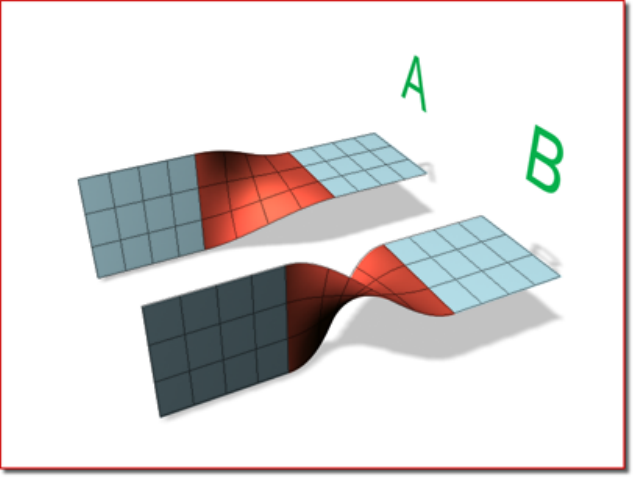
A. No flipping
B. End 2 is flipped.
Flip Tangent 1 and Flip Tangent 2 Flip the tangent at the edge of the first
or second curve or surface. Flipping the tangent reverses the direction in which
the blend surface approaches the parent sub-object at that edge.
Flipping the tangent has no effect if the edge is a curve, unless the curve is a
curve on surface.
When you blend to a CV or point curve on surface, the new blend surface is
tangent to the surface on which the curve on surface lies. The Flip Tangent
controls are especially useful in this situation.
2352 | Chapter 10 Surface Modeling
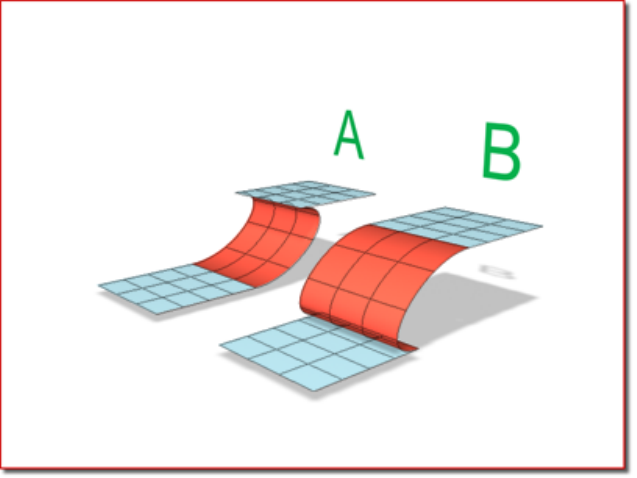
A. Tangent 1 flipped
B. Tangent 2 flipped
Start Point 1 and Start Point 2 Adjust the position of the start point at the
two edges of the blend. Adjusting the start points can help eliminate unwanted
twists or "buckles" in the surface.
These spinners are unavailable if the edges or curves are not closed.
While you're adjusting start points, a dotted blue line is displayed between
them, to show the alignment. The surface is not displayed, so it doesn't slow
down adjustment. When you release the mouse button, the surface reappears.
Flip Normals Turn on to reverse the direction of the blend surface normals.
Creating and Editing NURBS Sub-Objects | 2353
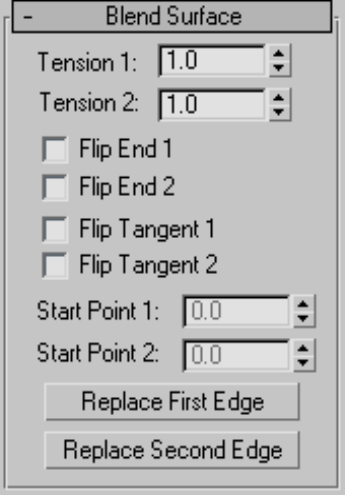
Blend Surface rollout (modification time)
"Tension" affects the tangent between a parent surface and the blend surface.
The greater the tension value, the more closely the tangent parallels the parent
surface, and the smoother the transition. The lower the tension, the greater
the tangent angle and the sharper the transition between parent and blend.
Tension 1 Controls tension at the edge of the first surface you clicked. This
value has no effect if the edge is a curve.
Tension 2 Controls tension at the edge of the second surface you clicked.
This value has no effect if the edge is a curve.
Flip End 1 and Flip End 2 Flip one of the normals used to construct the blend.
A blend surface is created using the normals of the parent surfaces. If the two
parents have opposing normals, or if a curve has the opposite direction, the
blend surface can be shaped like a bow tie. To correct the situation, use Flip
End 1 or Flip End 2 to construct the blend using a normal opposite the
corresponding parent surface's normal.
Flip Tangent 1 and Flip Tangent 2 Flip the tangent at the edge of the first
or second curve or surface. Flipping the tangent reverses the direction in which
the blend surface approaches the parent sub-object at that edge.
2354 | Chapter 10 Surface Modeling

Flipping the tangent has no effect if the edge is a curve, unless the curve is a
curve on surface.
When you blend to a CV or point curve on surface, the new blend surface is
tangent to the surface on which the curve on surface lies. The Flip Tangent
controls are especially useful in this situation.
Start Point 1 and Start Point 2 Adjust the position of the start point at the
two edges of the blend. Adjusting the start points can help eliminate unwanted
twists or "buckles" in the surface.
These spinners are unavailable if the edges or curves are not closed.
While you're adjusting start points, a dotted blue line is displayed between
them, to show the alignment. The surface is not displayed, so it doesn't slow
down adjustment. When you release the mouse button, the surface reappears.
Replace First Edge and Replace Second Edge Let you replace the parent
edges or curves. Click a button, then click the edge to replace the original first
or second edge. The edge can be on the same surface as the original edge, or
on a different surface.
Offset Surface
Select NURBS object. > Modify panel > Create Surfaces rollout > Dependent
Surfaces group box > Offset
Select NURBS object. > Modify panel > NURBS toolbox > Create Offset Surface
button
An Offset surface is offset a specified distance from the original along the
parent surface's normals.
Creating and Editing NURBS Sub-Objects | 2355
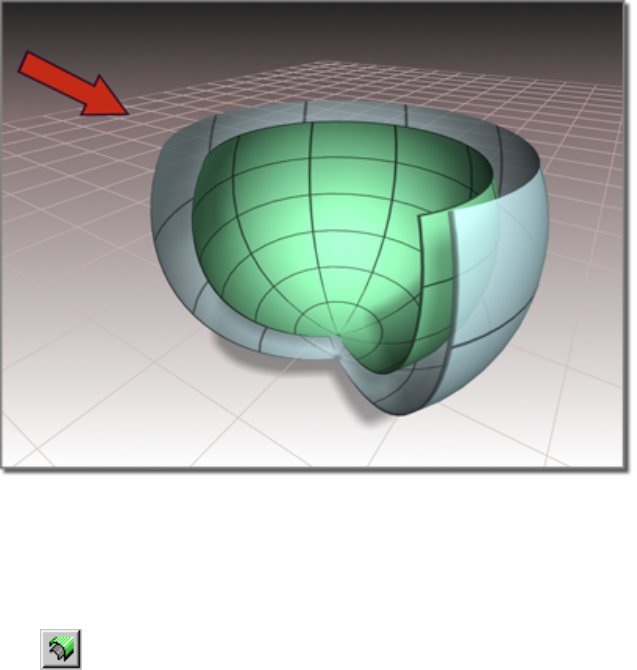
Surface created as an offset
Procedures
To create an offset surface:
1 In a NURBS object that contains at least one surface, turn on Offset.
2Click the surface you want to offset, and drag to set the initial distance
of the offset surface.
The offset surface is created.
3Adjust the Offset parameter.
Interface
While an offset surface sub-object is selected, a rollout with the offset Distance
parameter is displayed at the bottom of the Modify panel.
2356 | Chapter 10 Surface Modeling
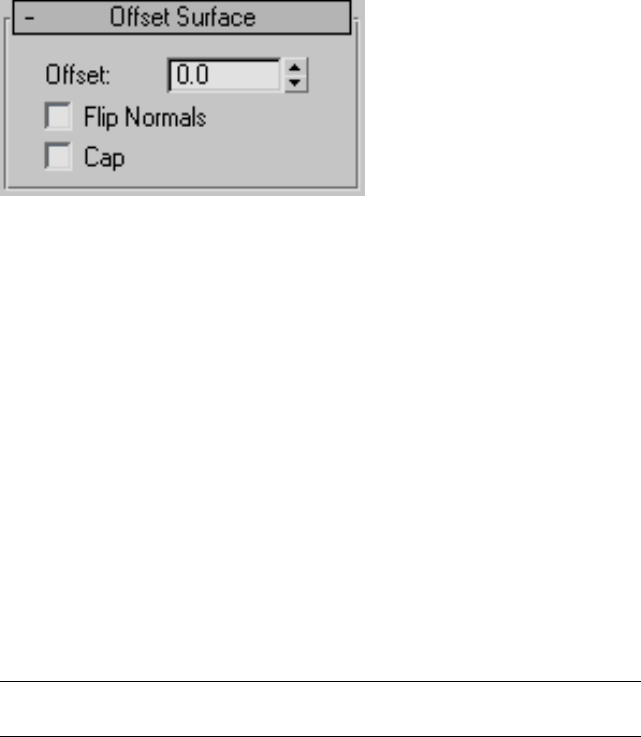
Offset Surface rollout (creation time)
Offset The distance between the parent surface and the offset surface, in 3ds
Max units.
If the parent surface is planar, the appearance of the offset surface doesn't
change with distance. If the parent surface is curved, increasing the offset
value increasingly exaggerates the curvature of the offset surface.
Flip Normals Lets you flip the surface normals at creation time. (After
creation, you can flip normals using controls on the Surface Common rollout.)
Cap When on, eight boundary curves are generated (four at the four edges
of each surface), and then generates four ruled surfaces to connect the two
original surfaces. While they are present, cap surfaces are maintained so they
match the dimensions of the offset and its parent.
The Cap check box appears only on the creation rollout. If you want to remove
the caps later, simply select them as surface sub-objects and delete them. Think
of offset capping as a workflow shortcut rather than a property (or parameter)
of offset surfaces.
To flip the normal of an offset cap, select it as a surface sub-object and use the
Flip Normals toggle on the Surface Common rollout.
NOTE If you trim the original surface, or make the offset surface independent and
then trim it, the capping surfaces will look strange.
Creating and Editing NURBS Sub-Objects | 2357
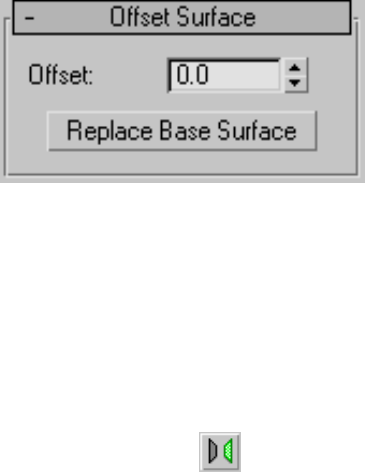
Offset Surface rollout (modification time)
Offset The distance between the parent surface and the offset surface in 3ds
Max units.
If the parent surface is planar, the appearance of the offset surface doesn't
change with distance. If the parent surface is curved, increasing the offset
value increasingly exaggerates the curvature of the offset surface.
Replace Base Surface Lets you replace the parent surface. Click the button,
then click the new surface on which to base the offset.
Mirror Surface
Select NURBS object. > Modify panel > Create Surfaces rollout > Dependent
Surfaces group box > Mirror
Select NURBS object. > Modify panel > NURBS toolbox > Create Mirror Surface
button
A mirror surface is a mirror image of the original surface.
2358 | Chapter 10 Surface Modeling
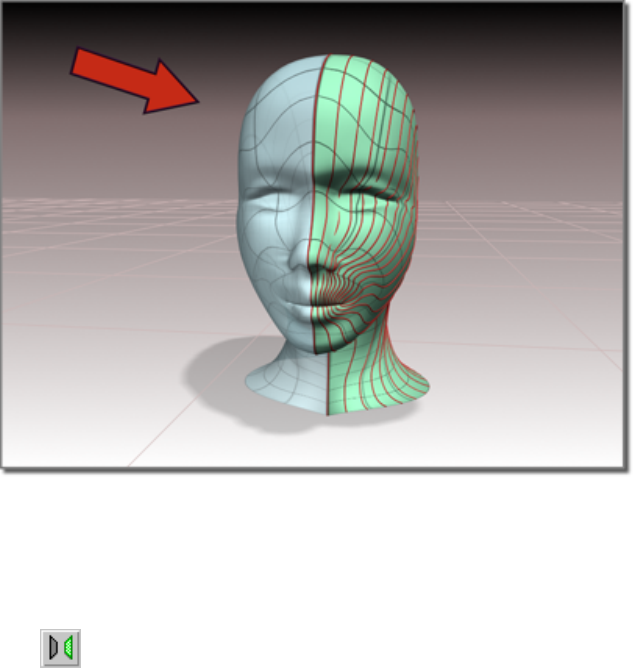
Surface created as a mirror
Procedures
To create a mirror surface:
1 In a NURBS object that contains at least one surface, turn on Mirror.
2On the Mirror Surface rollout, choose the axis or plane you want to use.
3Click the surface you want to mirror, and drag to set the initial distance
of the mirror surface.
The mirror surface is created. A gizmo (yellow by default) indicates the
direction of mirroring. Transforming the mirror surface's gizmo changes
the orientation of the mirror, letting you mirror along an axis that isn't
aligned with a local coordinate axis.
The Flip Normals control lets you flip the surface normals at creation
time. (After creation, you can flip normals using controls on the Surface
Common rollout.)
4Adjust the Offset parameter.
Creating and Editing NURBS Sub-Objects | 2359
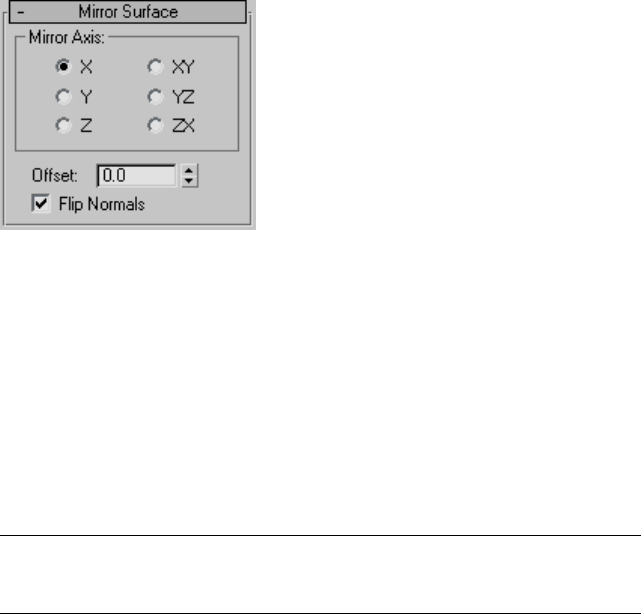
Interface
While a mirror surface sub-object is selected, the Mirror Surface rollout appears
at the bottom of the Modify panel. Also, a gizmo (yellow by default) indicates
the mirror axis.
Mirror Surface rollout (creation time)
Mirror Axis group
The Mirror Axis buttons control the direction in which the original surface is
mirrored.
You can't transform the mirror surface directly (that would simply transform
the mirror surface and its parent surface at the same time). You transform it
by transforming its gizmo. By using transforms you can mirror about an
arbitrary axis, rather than using one of the Mirror Axis presets. When you
transform a mirror surface, you are actually transforming the mirror plane, so
Rotate has the effect of rotating the plane about which the surface is mirrored.
(This is like rotating the mirror gizmo in the Mirror modifier.)
TIP A convenient way to guarantee that a surface is symmetrical is to create one
side of the surface, mirror that surface, and then create a blend between the two
sides.
Offset Controls the mirror's distance from the original surface. This parameter
is animatable.
Flip Normals Lets you flip the surface normals.
2360 | Chapter 10 Surface Modeling
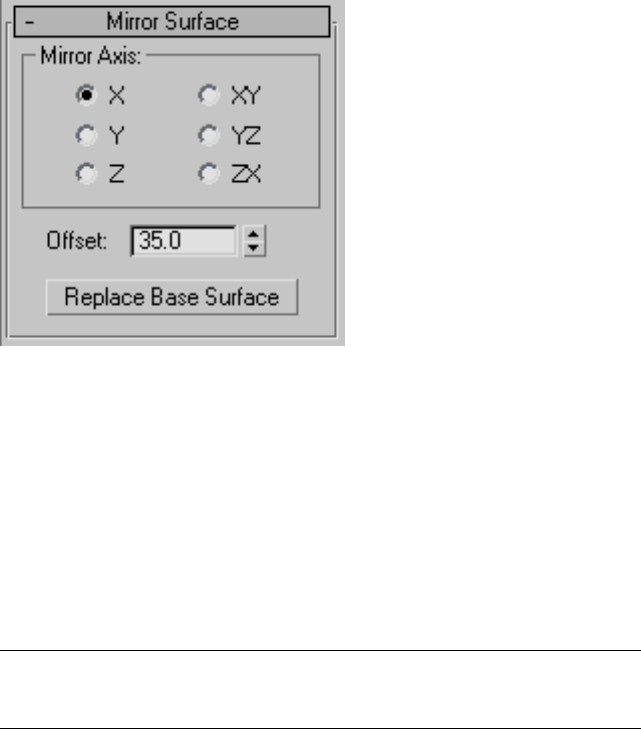
Mirror Surface rollout (modification time)
Mirror Axis group
The Mirror Axis buttons control the direction in which the original surface is
mirrored.
You can't transform the mirror surface directly (that would simply transform
the mirror surface and its parent surface at the same time). You transform it
by transforming its gizmo. By using transforms you can mirror about an
arbitrary axis, rather than using one of the Mirror Axis presets. When you
transform a mirror surface, you are actually transforming the mirror plane, so
Rotate has the effect of rotating the plane about which the surface is mirrored.
(This is like rotating the mirror gizmo in the Mirror modifier.)
TIP A convenient way to guarantee that a surface is symmetrical is to create one
side of the surface, mirror that surface, and then create a blend between the two
sides.
Offset Controls the mirror's distance from the original surface. This parameter
is animatable.
Replace Base Surface Lets you replace the parent surface. Click the button,
then click the new surface on which to base the mirror.
Creating and Editing NURBS Sub-Objects | 2361
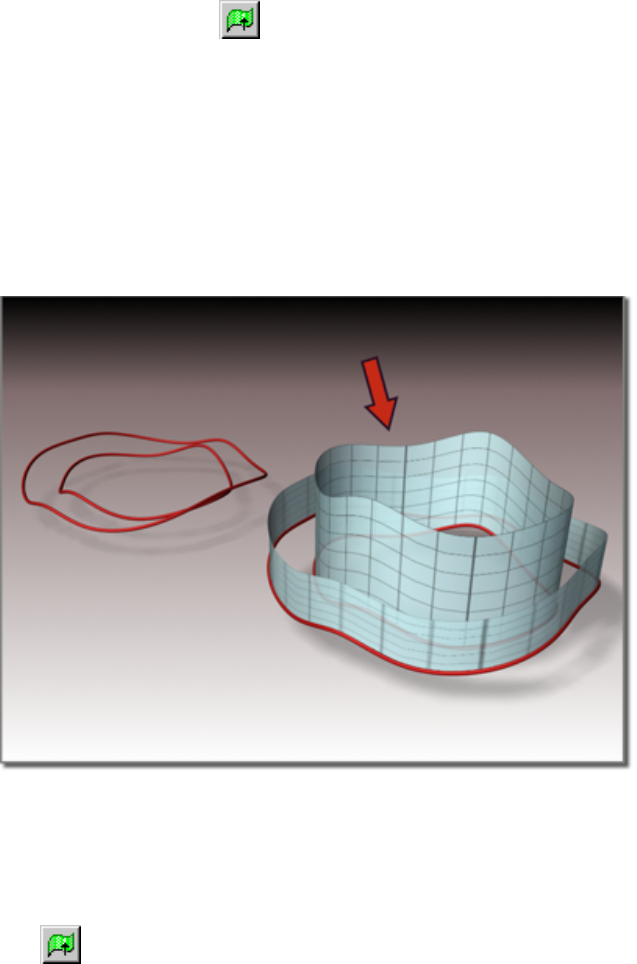
Extrude Surface
Select NURBS object. > Modify panel > Create Surfaces rollout > Dependent
Surfaces group box > Extrude
Select NURBS object. > Modify panel > NURBS toolbox > Create Extrude Surface
button
An extrude surface is extruded from a curve sub-object. It is similar to a surface
created with the Extrude modifier. The advantage is that an extrude sub-object
is part of the NURBS model, so you can use it to construct other curve and
surface sub-objects.
Surface extruded from a curve
Procedures
To create an extrude surface:
1 In a NURBS object that contains at least one curve, turn on Extrude.
2362 | Chapter 10 Surface Modeling
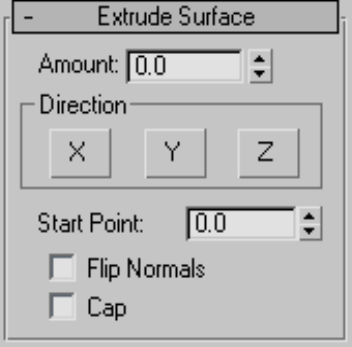
2Move the cursor over the curve to extrude, and drag to set the initial
amount.
By default, the surface extrudes along the NURBS model's local Z axis. A
gizmo (yellow by default) indicates the direction of extrusion.
Transforming the extrude surface's gizmo changes the direction of the
extrude, letting you extrude along an axis that isn't aligned with a local
coordinate axis.
The Flip Normals control lets you flip the surface normals at creation
time. (After creation, you can flip normals using controls on the Surface
Common rollout.)
3Adjust the extrusion parameters.
Interface
While an extrude sub-object is selected, a rollout with the extrusion parameters
is displayed at the bottom of the Modify panel.
Extrude Surface rollout (creation time)
Amount The distance the surface is extruded from the parent curve in current
3ds Max units.
This parameter is animatable.
Creating and Editing NURBS Sub-Objects | 2363
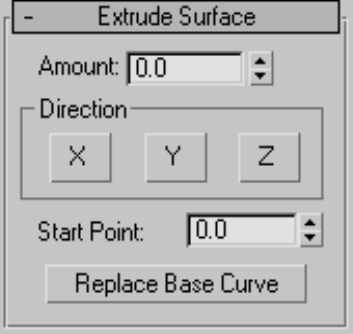
Direction group
X, Y and Z Choose the axis of extrusion. Default=Z.
Start Point Adjusts the position of the curve's start point. This can help
eliminate unwanted twists or "buckles" in the surface.
This control is disabled if the curve is not a closed curve.
The start point is displayed as a blue circle.
Flip Normals Lets you flip the surface normals at creation time. (After
creation, you can flip normals using controls in the Surface Common rollout.)
Cap When on, two surfaces are generated to close the ends of the extrusion.
While they are present, the cap surfaces are maintained so they match the
dimensions of the extrude surface. The parent curve must be a closed curve.
The Cap check box appears only on the creation rollout. If you want to remove
the caps later, simply select them as surface sub-objects and delete them. Think
of extrude capping as a workflow shortcut rather than a property (or parameter)
of extrude surfaces.
To flip the normal of an extrude cap, select it as a Surface sub-object and use
the Flip Normals toggle on the Surface Common rollout.
Extrude Surface rollout (modification time)
Amount The distance the surface is extruded from the parent curve in current
3ds Max units.
2364 | Chapter 10 Surface Modeling

Direction group
X, Y and Z Choose the axis of extrusion. Default=Z.
Start Point Adjusts the position of the curve's start point. This can help
eliminate unwanted twists or "buckles" in the surface.
This control is disabled if the curve is not a closed curve.
The start point is displayed as a blue circle.
Replace Base Curve Lets you replace the parent curve. Click the button, then
click the new curve on which to base the extruded surface.
Lathe Surface
Select NURBS object. > Modify panel > Create Surfaces rollout > Dependent
Surfaces group box > Lathe
Select NURBS object. > Modify panel > NURBS toolbox > Create Lathe Surface
button
A lathe surface is generated from a curve sub-object. It is similar to a surface
created with the Lathe modifier. The advantage is that a lathe sub-object is
part of the NURBS model, so you can use it to construct other curve and surface
sub-objects.
Creating and Editing NURBS Sub-Objects | 2365
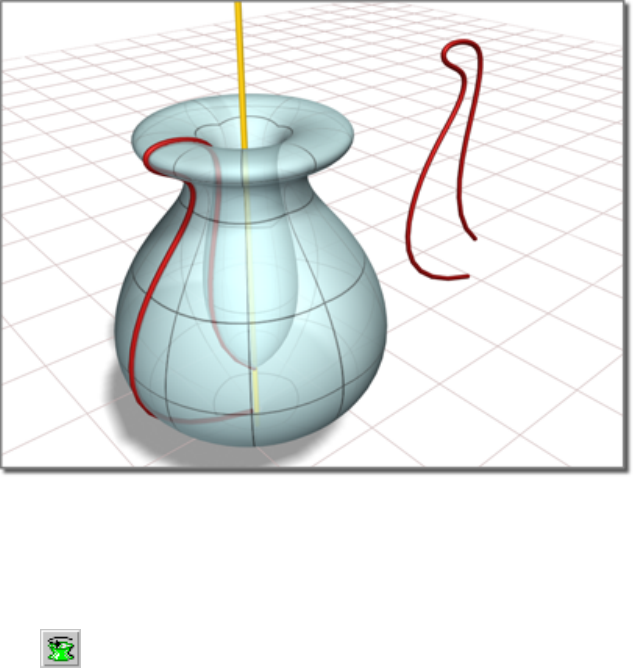
Surface created by lathing a curve
Procedures
To create a lathe surface:
1 In a NURBS object that contains at least one curve, turn on Lathe.
2Click the curve to lathe.
The lathe surface rotates about the NURBS model's local Y axis. The initial
lathe amount is 360 degrees. A gizmo (yellow by default) indicates the
axis of the lathe. Transforming the lathe surface's gizmo changes the
shape of the lathe, and lets you lathe around an axis that isn't aligned
with a local coordinate axis.
2366 | Chapter 10 Surface Modeling
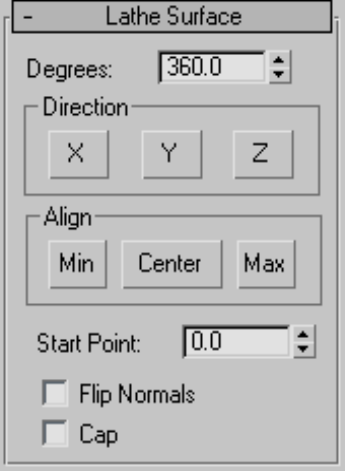
The Flip Normals control lets you flip the surface normals at creation
time. (After creation, you can flip normals using controls on the Surface
Common rollout.)
3Adjust the lathe parameters.
Interface
While a lathe sub-object is selected, a rollout with the lathe parameters is
displayed at the bottom of the Modify panel.
Creating and Editing NURBS Sub-Objects | 2367
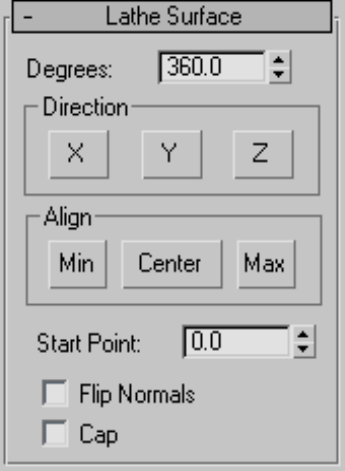
Lathe Surface rollout (creation time)
Degrees Sets the angle of rotation. At 360 degrees (the default), the surface
completely surrounds the axis. At lower values, the surface is a partial rotation.
2368 | Chapter 10 Surface Modeling
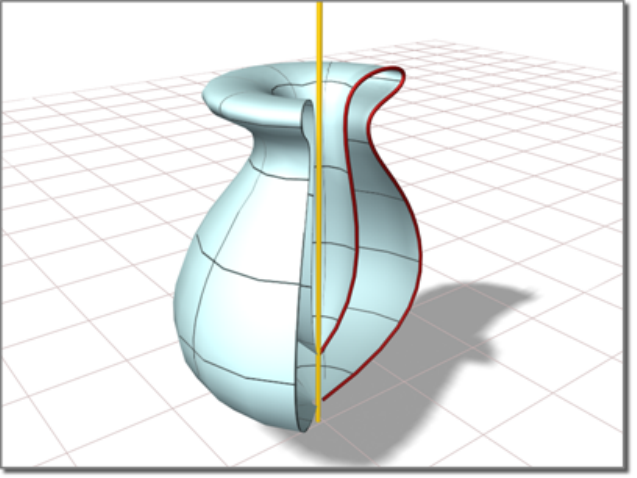
A partial lathe (degrees=225)
Direction group
X, Y, and Z Choose the axis of rotation. Default=Y.
Creating and Editing NURBS Sub-Objects | 2369
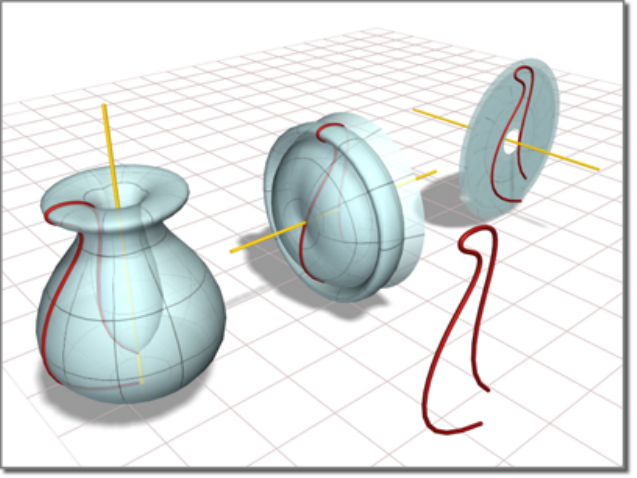
X, Y, and Z rotations of the same curve
Align group
These buttons position the axis of rotation relative to the curve.
Min (The default.) Locates the lathe axis at the curve's negative local X-axis
boundary.
Center Locates the lathe axis at the curve's center.
Max Locates the lathe axis at the curve's positive local X-axis boundary.
2370 | Chapter 10 Surface Modeling
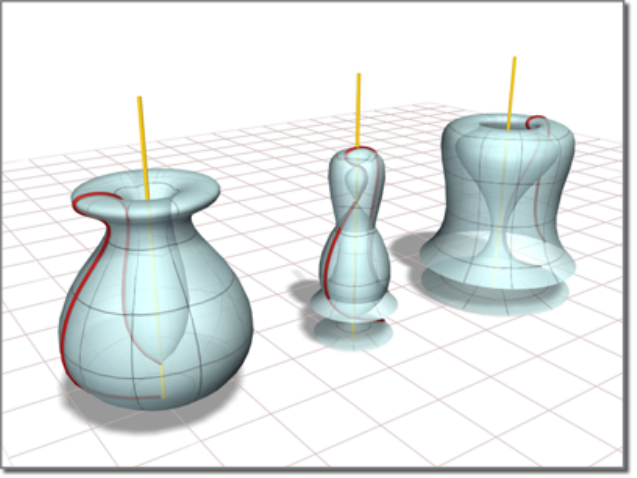
Min, Center, and Max lathes of the same curve
Start Point Adjusts the position of the curve's start point. This can help
eliminate unwanted twists or "buckles" in the surface.
This control is disabled if the curve is not a closed curve.
The start point is displayed as a blue circle.
Flip Normals Lets you flip the surface normals at creation time. (After
creation, you can flip normals using controls on the Surface Common rollout.)
Cap When on, two surfaces are generated to close the ends of the lathe.
While they are present, the cap surfaces are maintained so they match the
dimensions of the lathe surface. The lathe must be a 360-degree lathe.
The Cap check box appears only on the creation rollout. If you want to remove
the caps later, simply select them as surface sub-objects and delete them. Think
of lathe capping as a workflow shortcut rather than a property (or parameter)
of lathe surfaces.
To flip the normal of a lathe cap, select it as a Surface sub-object and use the
Flip Normals toggle on the Surface Common rollout.
Creating and Editing NURBS Sub-Objects | 2371
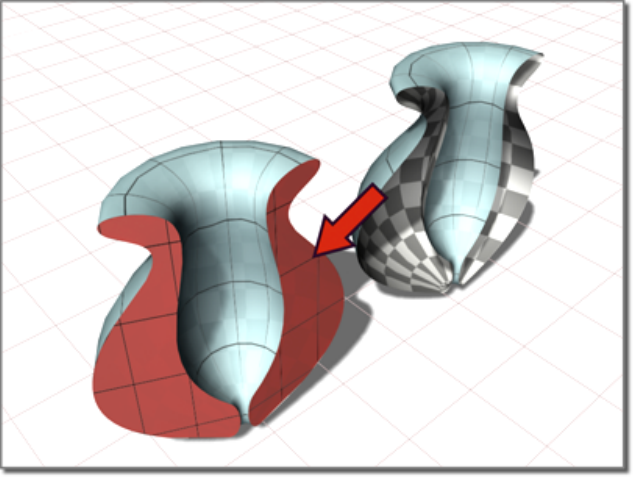
Adding a cap to a partial lathe
2372 | Chapter 10 Surface Modeling
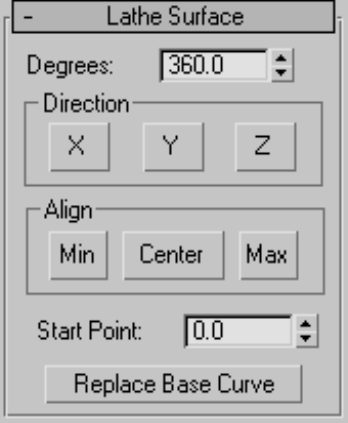
Lathe Surface rollout (modification time)
Degrees Sets the angle of rotation. At 360 degrees (the default), the surface
completely surrounds the axis. At lower values, the surface is a partial rotation.
Direction group
X Y and Z Choose the axis of rotation. Default=Y.
Align group
These buttons position the axis of rotation relative to the curve.
Min (The default.) Locates the lathe axis at the curve's negative local X-axis
boundary.
Center Locates the lathe axis at the curve's center.
Max Locates the lathe axis at the curve's positive local X-axis boundary.
Start Point Adjusts the position of the curve's start point. This can help
eliminate unwanted twists or "buckles" in the surface.
This control is disabled if the curve is not a closed curve.
The start point is displayed as a blue circle.
Creating and Editing NURBS Sub-Objects | 2373
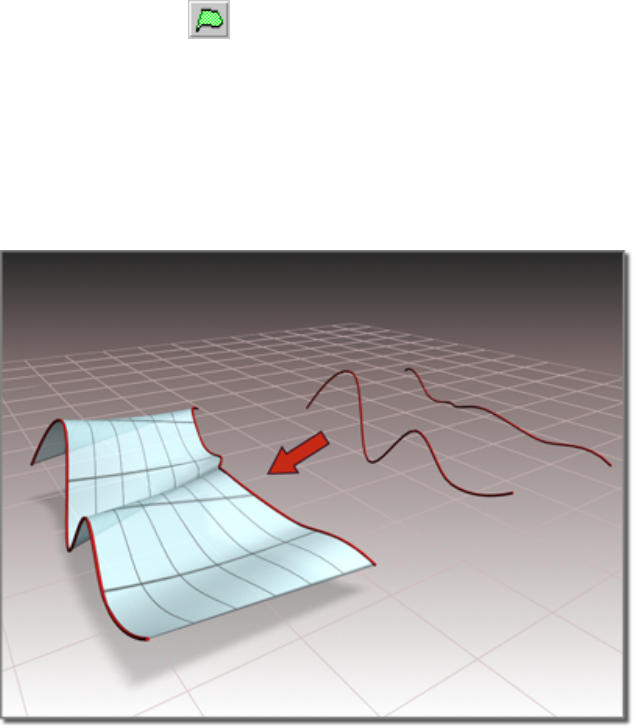
Replace Base Curve Lets you replace the parent curve. Click the button, then
click the new surface on which to base the lathed surface.
Ruled Surface
Select NURBS object. > Modify panel > Create Surfaces rollout > Dependent
Surfaces group box > Ruled
Select NURBS object. > Modify panel > NURBS toolbox > Create Ruled Surface
button
A ruled surface is generated from two curve sub-objects. It lets you use curves
to design the two opposite borders of a surface.
Using two curves to create a ruled surface
You can animate the parent curves or their CVs to change the ruled surface.
2374 | Chapter 10 Surface Modeling
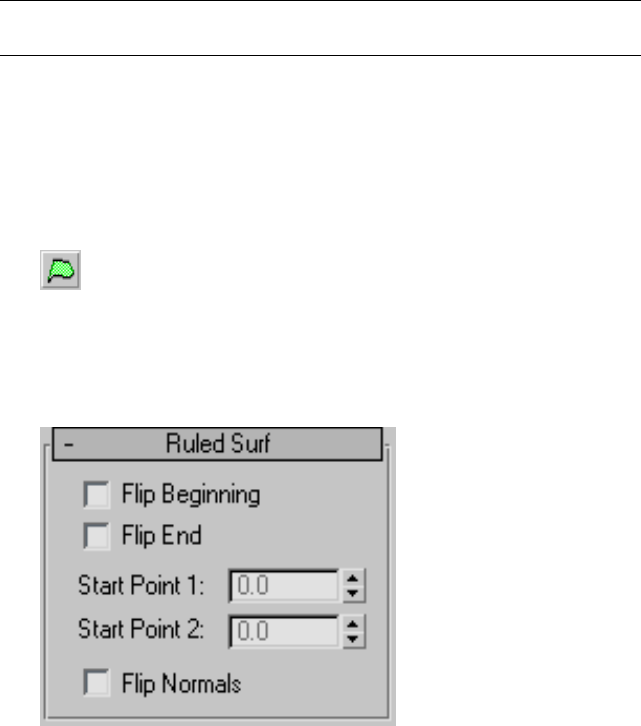
Automatic Curve Attachment
When you create a ruled surface, you can select curves that are not already
sub-objects of the active NURBS model. You can select another curve or spline
Splines object in the scene. When you select that curve, it attaches to the
current object as if you had used the Attach button on page 2225 .
WARNING If the curve you attach is a sub-object of another NURBS model, the
entire model (that is, the curve's parent NURBS object) is attached as well.
As you move the mouse over a curve that is not part of the active NURBS
object, the cursor changes shape to indicate that you can pick the curve, but
the curve is not highlighted in blue.
Procedures
To create a ruled surface:
1 In a NURBS object that contains at least two curves, turn on Ruled.
2Drag from one curve to the other.
You can also click first one curve, then the other.
A dependent surface is generated, using the two curves as the surface's
opposite edges. The perpendicular edges are generated automatically.
The Flip Normals control lets you flip the surface normals at creation
time. (After creation, you can flip normals using controls on the Surface
Common rollout.)
Creating and Editing NURBS Sub-Objects | 2375
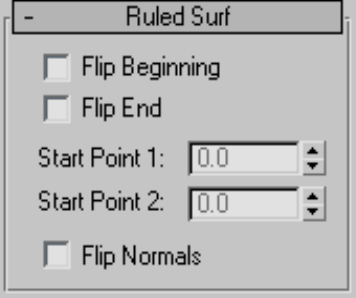
Interface
When you turn on the Ruled button, and while a ruled surface sub-object is
selected, a rollout with the ruled surface parameters is displayed at the bottom
of the Modify panel.
Ruled Surf rollout (creation time)
Flip Beginning and Flip End Flip one of the curve directions used to construct
the ruled surface. A ruled surface is created using the directions of the parent
curves. If the two parents have opposing directions, the ruled surface can be
shaped like a bow tie. To correct the situation, use Flip Beginning or Flip End
to construct the ruled surface using a direction opposite the corresponding
parent curve's direction. These controls eliminate the need to reverse the curve.
Start Point 1 and Start Point 2 Adjust the position of the start point at the
two curves that specify the ruled surface. Adjusting the start points can help
eliminate unwanted twists or "buckles" in the surface.
These spinners are disabled if the edges or curves are not closed.
While you're adjusting start points, a dotted blue line is displayed between
them, to show the alignment. The surface is not displayed, so it doesn't slow
down adjustment. When you release the mouse button, the surface reappears.
Flip Normals Turn on to reverse the direction of the ruled surface's normals.
2376 | Chapter 10 Surface Modeling
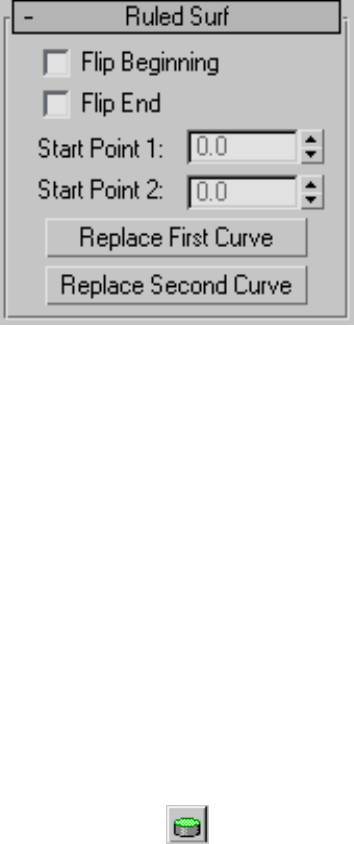
Ruled Surf rollout (modification time)
Flip Beginning and Flip End Flip one of the curve directions used to construct
the ruled surface. A ruled surface is created using the directions of the parent
curves. If the two parents have opposing directions, the ruled surface can be
shaped like a bow tie. To correct the situation, use Flip Beginning or Flip End
to construct the ruled surface using a direction opposite the corresponding
parent curve's direction. These controls eliminate the need to reverse the curve.
Start Point 1 and Start Point 2 Adjust the position of the start point at the
two curves that specify the ruled surface. Adjusting the start points can help
eliminate unwanted twists or "buckles" in the surface.
These spinners are disabled if the edges or curves are not closed.
While you're adjusting start points, a dotted blue line is displayed between
them, to show the alignment. The surface is not displayed, so it doesn't slow
down adjustment. When you release the mouse button, the surface reappears.
Replace First Curve and Replace Second Curve Let you replace the parent
curves. Click a button, then click the curve to replace the original first or
second curve.
Cap Surface
Select NURBS object. > Modify panel > Create Surfaces rollout > Dependent
Surfaces group box > Cap
Creating and Editing NURBS Sub-Objects | 2377
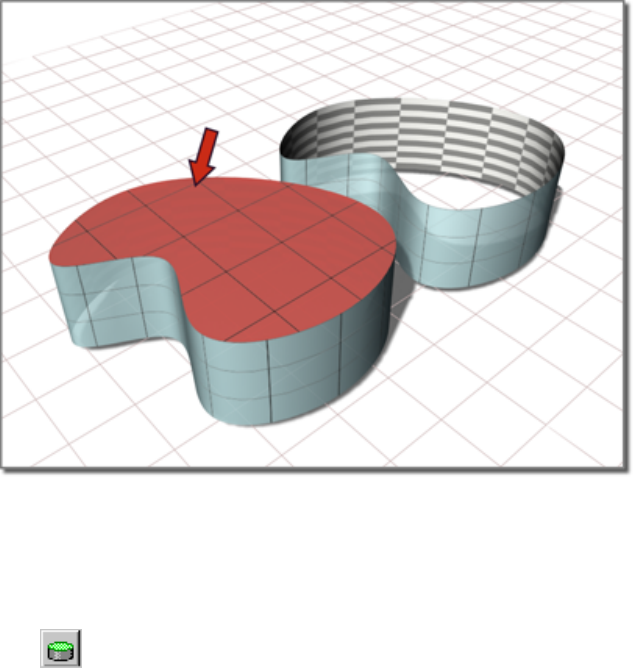
Select NURBS object. > Modify panel > NURBS toolbox > Create Cap Surface
button
This command creates a surface that caps a closed curve or the edge of a closed
surface. Caps are especially useful with extruded surfaces.
Capping an extrude surface
Procedures
To create a cap surface:
1 In a NURBS object, turn on Cap.
2Move the mouse over the closed curve or the closed edge of a closed
surface.
If the cap can be created, the curve or edge is highlighted in blue.
3Click the highlighted curve or edge.
2378 | Chapter 10 Surface Modeling
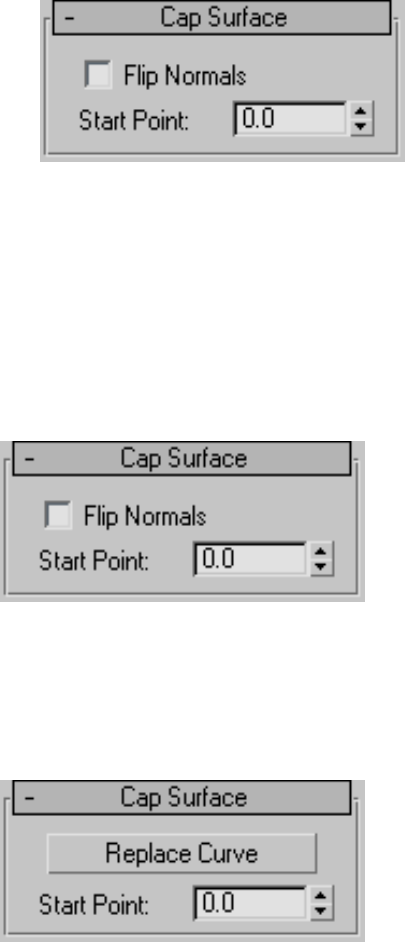
The Flip Normals control lets you flip the surface normals at creation
time. (After creation, you can flip normals using controls on the Surface
Common rollout.)
Interface
While a cap surface sub-object is selected, a rollout with cap surface controls
is displayed at the bottom of the Modify panel.
Cap Surface rollout (creation time)
Flip Normals Turn on to reverse the direction of the cap surface's normals.
Start Point Adjusts the position of the edge or curve's start point.
The start point is displayed as a blue circle.
Cap Surface rollout (modification time)
Replace Curve Lets you replace the parent curve or edge. Click the button,
then click the new curve or edge on which to base the cap.
Creating and Editing NURBS Sub-Objects | 2379
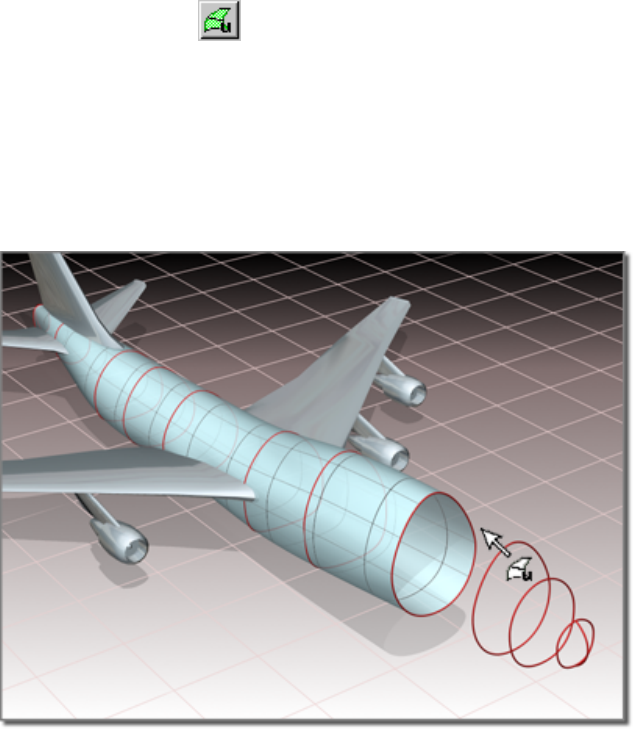
Start Point Adjusts the position of the edge or curve's start point.
The start point is displayed as a blue circle.
U Loft Surface
Select NURBS object. > Modify panel > Create Surfaces rollout > Dependent
Surfaces group box > U Loft
Select NURBS object. > Modify panel > NURBS toolbox > Create U Loft Surface
button
A U loft surface interpolates a surface across multiple curve sub-objects. The
curves become U-axis contours of the surface.
Using multiple curves to create a U Loft surface
Tips
■A U loft can be an extremely dense surface. To improve performance while
working with viewports, set the surface approximation on page 2469 for
viewports to Curvature Dependent.
2380 | Chapter 10 Surface Modeling
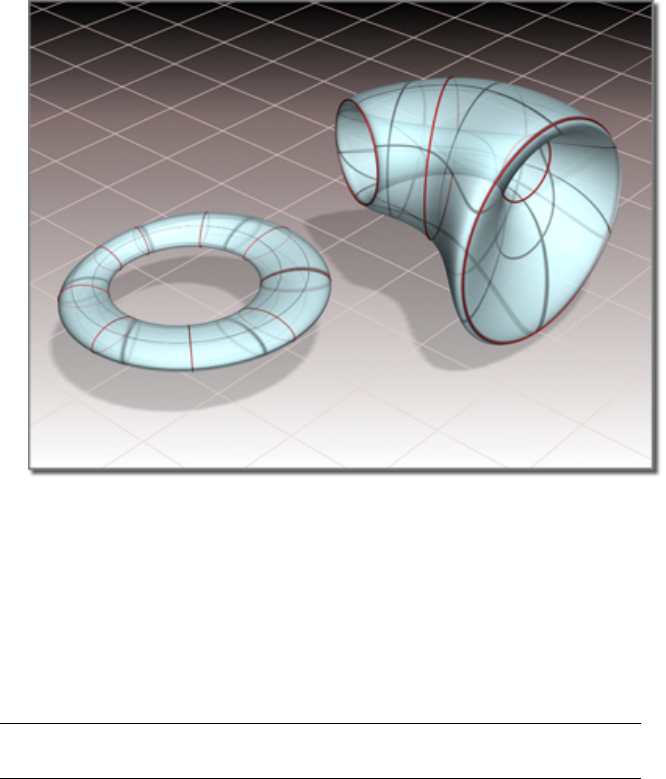
■You can speed up U loft creation by making sure that the curves you loft
have the same number of CVs in the same order (that is, the curves point
in the same direction). Also, CV curves have a performance advantage over
point curves.
■Turning off display of dependent sub-objects, including the U loft itself,
also speeds up interactive performance when you create a U loft. The
default keyboard toggle for dependent sub-object display is Ctrl+D (the
Keyboard Shortcut Override Toggle on page 7646 button must be on.)
Closed U lofts
Automatic Curve Attachment
When you create a U loft, you can select curves that are not already sub-objects
of the active NURBS model. You can select another curve or spline on page
542 object in the scene. When you select that curve, it is automatically attached
to the current object as if you had used the Attach button.
WARNING If the curve you attach is a sub-object of another NURBS model, the
entire model (that is, the curve's parent NURBS object) is attached as well.
Creating and Editing NURBS Sub-Objects | 2381

As you move the mouse over a curve that is not part of the active NURBS
object, the cursor changes shape to indicate you can pick the curve, but the
curve is not highlighted in blue.
Procedures
To create a U loft surface:
1In a NURBS object that contains at least two curves, turn on U Loft.
2Click the first curve.
3Click additional curves in succession.
2382 | Chapter 10 Surface Modeling
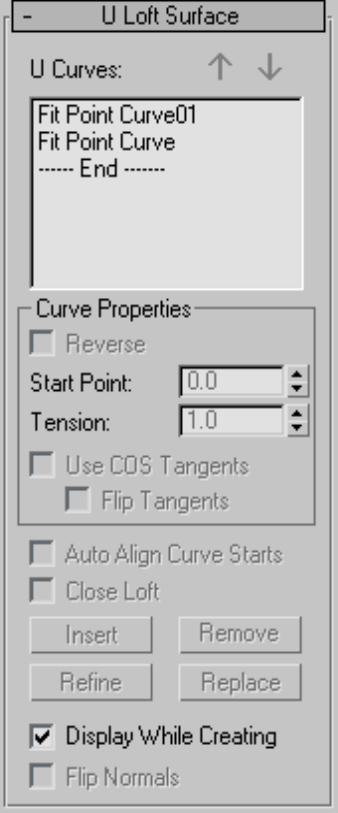
The U loft is created. It is "stretched" across the curves you click. The
order in which you click the curves can affect the shape of the U loft
surface. The names of the curves appear in the U Loft Surface creation
rollout.
While creating a U loft, you can press Backspace to remove the last curve
you clicked from the list of U loft curves.
Creating and Editing NURBS Sub-Objects | 2383

The Flip Normals control lets you flip the surface normals at creation
time. (After creation, you can flip normals using controls on the Surface
Common rollout.)
4Right-click to end U loft creation.
To create a U loft with automatic attach (example):
1From the Create panel, create three or more independent CV or Point
NURBS curves.
2Go to the Modify panel, and click to turn on U Loft in the NURBS toolbox.
3Select the curves in the appropriate order for the loft.
The U loft is created. You don't have to collapse the curves to a NURBS
surface, or attach them to an existing NURBS model on page 2225 .
As you move the mouse over a curve that is not part of the active NURBS
object, the cursor changes shape to indicate you can pick the curve, but
the curve is not highlighted in blue.
Interface
While a U loft sub-object is selected, a rollout with the U loft parameters is
displayed at the bottom of the Modify panel. This rollout appears only when
one U loft sub-object is selected. It isn't possible to edit more than one U loft
at a time, so unlike some other NURBS sub-objects, the rollout doesn’t appear
when multiple U loft sub-objects are selected.
When you create lofted and swept surfaces, you have access to all the
parameters, and some of the editing operations, of the surface. You can reverse
and set start points on curves while you create the surface. You can also use
the arrow buttons to change the order of the curves, and you can remove a
curve with the Remove button.
TIP When you edit a U loft sub-object, close the Surface Common rollout to see
the U Loft Surface rollout more easily.
2384 | Chapter 10 Surface Modeling
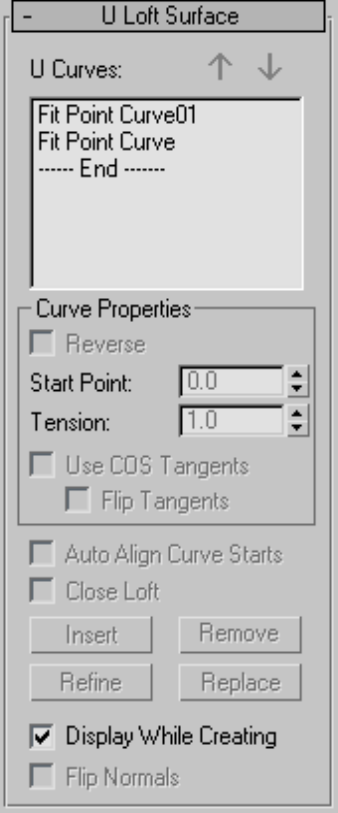
U Loft Surface rollout (creation time)
U Curves This list shows the name of the curves you click in the order you
click them. You can select curves by clicking their names. Viewports display
the selected curve in blue. Initially the first curve is the one selected.
You can also select more than one curve at a time. This is useful when you
use the Edit Curves button.
Creating and Editing NURBS Sub-Objects | 2385
Arrow Buttons Use these to change the order of curves used to construct the
U loft. Select a curve in the list, and then use the arrows to move the selection
up or down.
These buttons are available at creation time.
Curve Properties group
These controls affect individual curves you select in the U Curves list, as
opposed to properties of the loft surface in general. They are enabled only
when you have selected a curve in the U Curves list.
Reverse When set, reverses the direction of the selected curve.
Start Point Adjusts the position of the curve's start point.
This control is disabled if the curve is not a closed curve.
While you're adjusting start points, a dotted blue line is displayed between
them, to show the alignment. The surface is not displayed, so it doesn't slow
down adjustment. When you release the mouse button, the surface reappears.
Tension Adjusts the tension of the loft where it intersects that curve.
Use COS Tangents If the curve is a curve on surface, turning on this toggle
causes the U loft to use the tangency of the surface. This can help you blend
a loft smoothly onto a surface. Default=off.
This toggle is disabled unless the curve is a point or CV curve on surface.
Flip Tangents Reverses the direction of the tangents for that curve.
This toggle is disabled unless the curve is a point or CV curve on surface and
Use COS Tangents is on.
Auto Align Curve Starts (Disabled.)
Close Loft (Disabled.)
Insert (Disabled.)
Remove Removes a curve from the U loft surface. Select the curve in the list,
and then click Remove.
This button is available at creation time.
Refine (Disabled.)
Replace (Disabled.)
Display While Creating When on, the U loft surface is displayed while you
create it. When off, the loft is created more quickly. Default=off.
2386 | Chapter 10 Surface Modeling
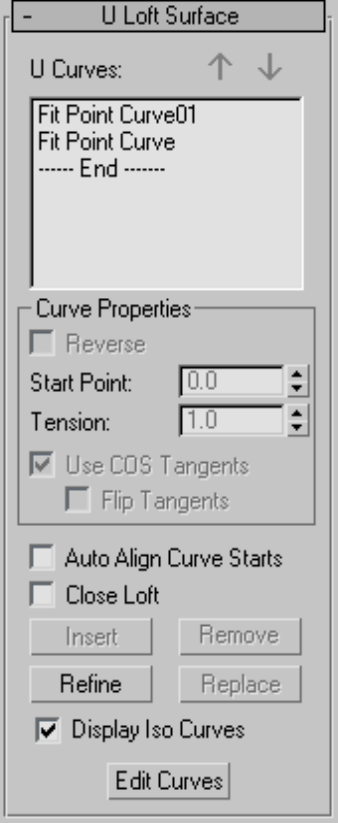
Flip Normals Reverses the direction of the U loft's normals.
U Loft Surface rollout (modification time)
U Curves This list shows the name of the curves you click, in the order you
click them. You can select curves by clicking their names in this list. Viewports
display the selected curve in blue. Initially the first curve is the one selected.
Creating and Editing NURBS Sub-Objects | 2387
You can also select more than one curve at a time. This is useful when you
use the Edit Curves button.
Arrow Buttons Use these to change the order of curves used to construct the
U loft. Select a curve in the list, and then use the arrows to move the selection
up or down.
These buttons are available at creation time.
Curve Properties group
These controls affect individual curves you select in the U Curves list, as
opposed to properties of the loft surface in general. They are enabled only
when you have selected a curve in the U Curves list.
Reverse When set, reverses the direction of the selected curve.
Start Point Adjusts the position of the curve's start point.
This control is disabled if the curve is not a closed curve.
While you're adjusting start points, a dotted blue line is displayed between
them, to show the alignment. The surface is not displayed, so it doesn't slow
down adjustment. When you release the mouse button, the surface reappears.
Tension Adjusts the tension of the loft where it intersects that curve.
Use COS Tangents If the curve is a curve on surface, turning on this toggle
causes the U loft to use the tangency of the surface. This can help you blend
a loft smoothly onto a surface. Default=off.
This toggle is disabled unless the curve is a point or CV curve on surface.
Flip Tangents Reverses the direction of the tangents for that curve.
This toggle is disabled unless the curve is a point or CV curve on surface and
Use COS Tangents is on.
Auto Align Curve Starts When on, aligns the start points of all curves in the
U loft. The software chooses the location of the start points. Using automatic
alignment minimizes the amount of twisting in the loft surface. Default=off.
Close Loft If the loft was initially an open surface, turning on this toggle
closes it by adding a new segment to connect the first curve and the last curve.
Default=off.
Insert Adds a curve to the U loft surface. Click to turn on Insert, then click
the curve. The curve is inserted before the selected curve. To insert a curve at
the end, first highlight the "----End-----" marker in the list.
2388 | Chapter 10 Surface Modeling

Remove Removes a curve from the U loft surface. Select the curve in the list,
and then click Remove.
This button is available at creation time.
Refine Refines the U loft surface. Click to turn on Refine, then click a U-axis
iso curve on the surface. (As you drag the mouse over the surface, the available
curves are highlighted.) The curve you click is converted to a CV curve and
inserted into the loft and the U Curves list. As when you refine a point curve,
refining a U loft can change the curvature of the surface slightly. Once you've
refined the surface by adding a U curve, you can use Edit Curve to change the
curve.
Replace Replaces a U curve with a different curve. Select a U curve, click to
turn on Replace, then click the new curve in a viewport. Available curves are
highlighted as you drag the mouse.
This button is enabled only when you've selected a single curve in the U Curves
list.
Display Iso Curves When set, the U loft's V-axis iso curves are displayed as
well as the U-axis curves used to construct the loft. The V-axis curves are only
for display. You can't use them for surface construction.
Edit Curve Lets you edit the currently selected curve without switching to
another sub-object level. Click to turn on Edit Curve. The points or CVs of
the curve are displayed, as well as the control lattice if the curve is a CV curve.
You can now transform or otherwise change the points or CVs as if you were
at the Point or Curve CV sub-object level. To finish editing the curve, click to
turn off Edit Curve.
When you turn on Edit Curves, all applicable rollouts for the selected curves
are displayed, including the Curve Common rollout, the CV or Point rollout
(depending on the curve type), and the CV Curve or Point Curve rollout.
These rollouts appear beneath the U Loft rollout. They let you edit the loft
curves and their points or CVs without having to switch sub-object levels.
TIP When you edit curves in a U loft, turning off display of the U loft itself can
make the curves easier to see and improve performance. Use Ctrl+D (while the
Keyboard Shortcut Override Toggle button on page 7646 is on) to toggle display
of dependent sub-objects, including U Lofts.
Creating and Editing NURBS Sub-Objects | 2389
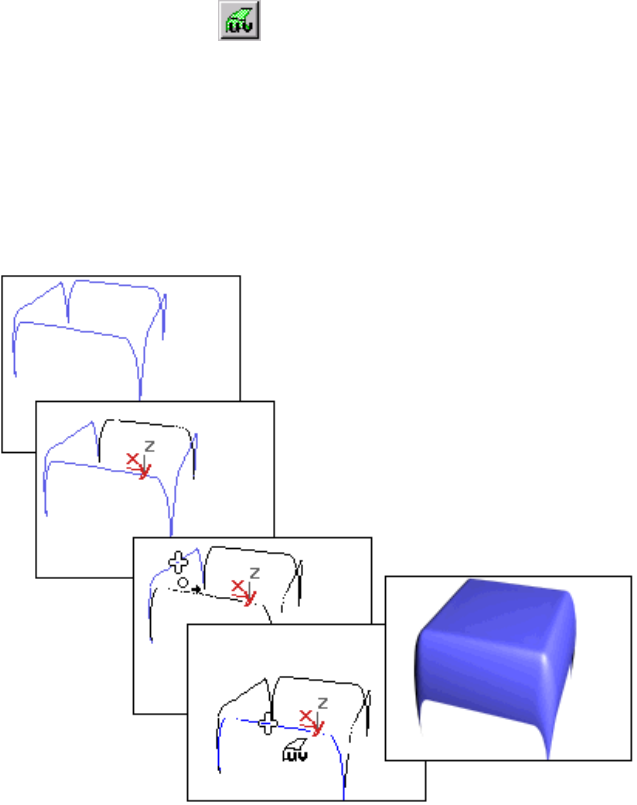
UV Loft Surface
Select NURBS object. > Modify panel > Create Surfaces rollout > Dependent
Surfaces group box > UV Loft
Select NURBS object. > Modify panel > NURBS toolbox > Create UV Loft Surface
button
A UV loft surface is similar to a U loft surface, but has a set of curves in the V
dimension as well as in the U dimension. This can give you finer control over
the lofted shape, and require fewer curves to achieve the result you want.
Using perpendicular curves to create a UV loft surface
If the U and V curves intersect, the UV loft surface interpolates all the curves.
If the curves don't intersect, the lofted surface lies somewhere between the U
and V curves. In general, UV loft works best if the ends of all the curves in
one direction lie on the two end curves in the other direction, as in the
illustration. UV loft does not work well if the curves in both directions are
closed.
2390 | Chapter 10 Surface Modeling
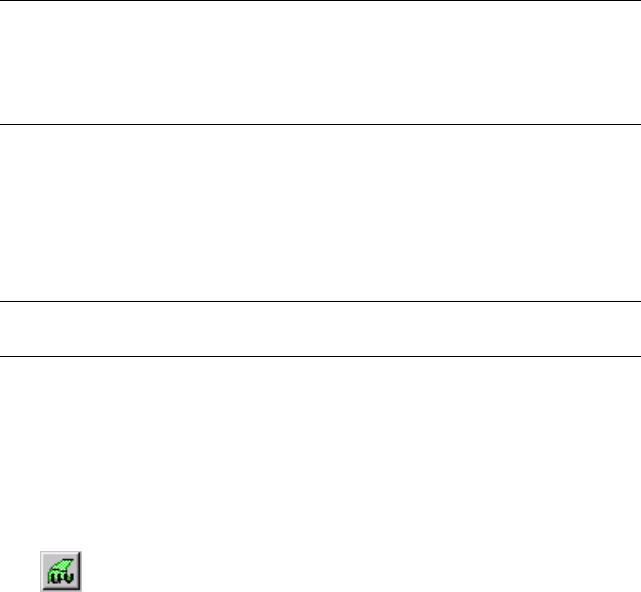
NOTE The Make Loft on page 2459 dialog (displayed by the Make Loft button on
the Surface Common rollout for surface sub-objects) now lets you convert a surface
to a UV loft as well as a U loft. In addition, you can use point curves instead of CV
curves for the new loft lattice. If you use point curves for a UV loft, turning on the
Fuse Points option guarantees that the U and V curves intersect.
Automatic Curve Attachment
When you create a UV loft, you can select curves that are not already
sub-objects of the active NURBS model. You can select another curve or spline
on page 542 object in the scene. When you select that curve, it attaches to the
current object as if you had used the Attach button on page 2225 .
WARNING If the curve you attach is a sub-object of another NURBS model, the
entire model (that is, the curve's parent NURBS object) is attached as well.
As you move the mouse over a curve that is not part of the active NURBS
object, the cursor changes shape to indicate that you can pick the curve, but
the curve is not highlighted in blue.
Procedures
To create a UV loft:
1 Create the curves that outline the surface you want to create.
2Click to turn on UV Loft in the toolbox or on the Create Surfaces rollout.
3Click each of the curves in the U dimension, then right-click. Click each
of the curves in the V dimension, then right-click again to end creation.
As you click curves, their names appear in the lists on the UV Loft Surface
creation rollout. The order in which you click the curves can affect the
shape of the UV loft surface.
In either dimension, you can click the same curve more than once. This
can help you create a closed UV loft.
To create a UV loft with automatic attach (example):
1From the Create panel, create three or more independent CV or point
NURBS curves.
2Go to the Modify panel, and click to turn on UV Loft in the NURBS
toolbox.
Creating and Editing NURBS Sub-Objects | 2391

3Select the curves in the appropriate order for the loft.
The UV loft is created. You don't need to collapse the curves to a NURBS
surface or Attach them to an existing NURBS model.
As you move the mouse over a curve that is not part of the active NURBS
object, the cursor changes shape to indicate that you can pick the curve,
but the curve is not highlighted in blue.
Interface
While a UV Loft sub-object is selected, a rollout with the UV loft parameters
appears. This rollout appears only when one UV loft sub-object is selected. It
isn’t possible to edit more than one UV loft at a time, so unlike some other
NURBS sub-objects, the rollout doesn’t appear when multiple UV loft
sub-objects are selected.
TIP When you edit a UV loft sub-object, close the Surface Common rollout to see
the U Loft Surface rollout more easily.
2392 | Chapter 10 Surface Modeling
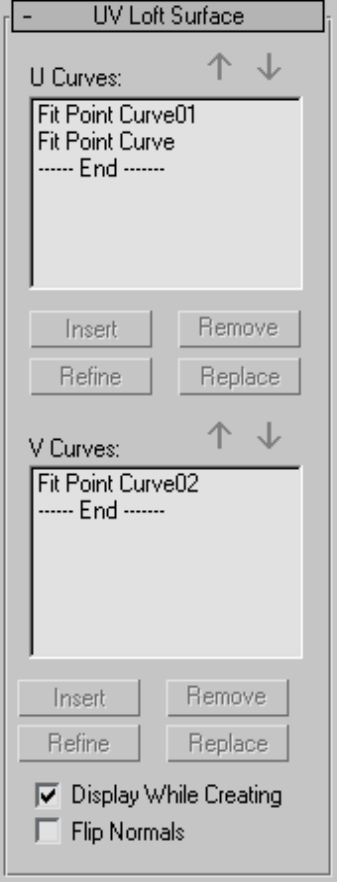
UV Loft Surface rollout (creation time)
Creating and Editing NURBS Sub-Objects | 2393
U Curves and V Curves These lists show the names of the curves you click,
in the order you click them. You can select a curve by clicking its name in a
list. Viewports display the selected curve in blue.
The two buttons above and the four below each list are identical for both lists.
While you create the loft, in either dimension you can click the same curve
more than once. This can help you create a closed UV loft.
Arrow Buttons Use these to change the order of curves in the U Curve or V
Curve list. Select a curve in the list, and then use the arrows to move the
selection up or down.
Insert (Disabled.)
Remove Removes a curve from the U list or V list. Select the curve in the
list, and then click Remove.
Refine (Disabled.)
Replace (Disabled.)
Display While Creating When on, the UV loft surface is displayed while you
create it. When off, the loft can be created more quickly. Default=off.
Flip Normals Reverses the direction of the UV loft's normals.
2394 | Chapter 10 Surface Modeling
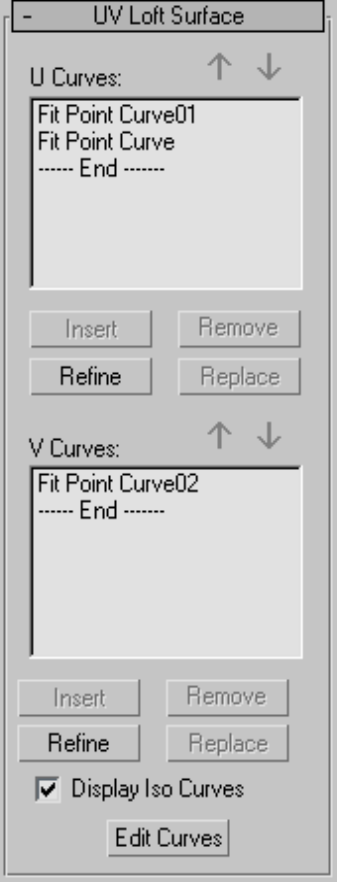
UV Loft Surface rollout (modification time)
Creating and Editing NURBS Sub-Objects | 2395
U Curves and V Curves These lists show the names of the curves you click,
in the order you click them. You can select a curve by clicking its name in a
list. Viewports display the selected curve in blue.
The two buttons above and the four below each list are identical for both lists.
Arrow Buttons Use these to change the order of curves in the U Curve or V
Curve list. Select a curve in the list, and then use the arrows to move the
selection up or down.
Insert Adds a curve to the U list or V list. Click to turn on Insert, then click
the curve. The curve is inserted before the selected curve. To insert a curve at
the end, first highlight the "----End-----" marker in the list.
Remove Removes a curve from the U list or V list. Select the curve in the
list, and then click Remove.
Refine Refines the UV loft surface. Click to turn on Refine, then click an iso
curve on the surface. (As you drag the mouse over the surface, the available
curves are highlighted.) The curve you click is converted to a CV curve and
inserted into the loft and the U Curves or V Curves list. As when you refine
a point curve, refining a UV loft can change the curvature of the surface
slightly. Once you’ve refined the surface by adding a U curve or V curve, you
can use Edit Curves to change the curve.
Replace Lets you replace the selected curve. Select a curve in the list, click
this button, then select the new curve.
Display Iso Curves When set, the UV loft’s iso curves are displayed as well
as the U-axis and V-axis curves used to construct the loft. The iso curves are
only for display. You can’t use them for surface construction.
Edit Curves Lets you edit the currently selected curve without switching to
another sub-object level. Click to turn on Edit Curve. The points or CVs of
the curve are displayed, as well as the control lattice if the curve is a CV curve.
You can now transform or otherwise change the points or CVs as if you were
at the Point or Curve CV sub-object level. To finish editing the curve, click to
turn off Edit Curves.
When you turn on Edit Curves, all applicable rollouts for the selected curves
are displayed, including the Curve Common rollout, the CV or Point rollout
(depending on the curve type), and the CV Curve or Point Curve rollout.
These rollouts appear beneath the U Loft rollout. They let you edit the loft
curves and their points or CVs without having to switch sub-object levels.
2396 | Chapter 10 Surface Modeling
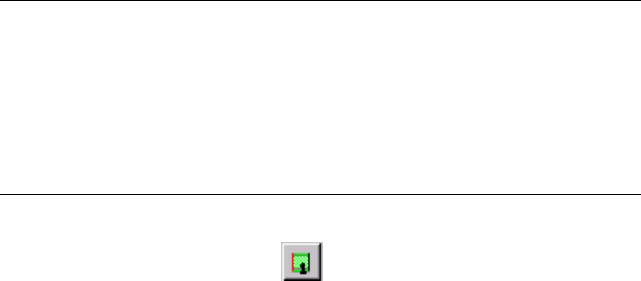
TIP When you edit curves in a UV loft, turning off display of the UV loft itself can
make the curves easier to see and improve performance. Use Ctrl+D (while the
Keyboard Shortcut Override Toggle button on page 7646 is on) to toggle display
of dependent sub-objects, including UV lofts.
The UV loft surface can deviate from the curve if you edit a curve in a UV loft
by increasing the weight of the curve CVs. You can work around this by
refining the curve at the point where the surface deviates.
1-Rail Sweep Surface
Select NURBS object. > Modify panel > Create Surfaces rollout > Dependent
Surfaces group box > 1-Rail
Select NURBS object. > Modify panel > NURBS toolbox > Create 1-Rail Sweep
button
Sweep surfaces are constructed from curves. A 1-rail sweep surface uses at least
two curves. One curve, the "rail," defines one edge of the surface. The other
curves define the surface's cross sections.
Creating and Editing NURBS Sub-Objects | 2397
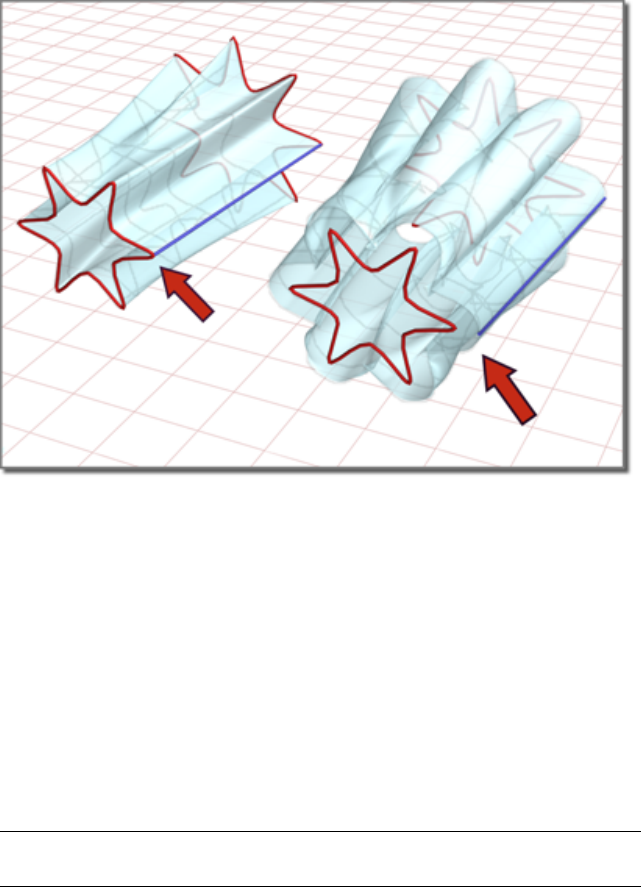
1-rail sweep surface
Changing the position of the rail can change the shape of the surface.
The cross-section curves should intersect the rail curve. If the cross-sections
don't intersect the rail, the resulting surface is unpredictable. In addition, the
initial point of the rail and the initial point of the first cross-section curve
must be coincident. Use NURBS Snaps on page 2578 to accomplish this.
Automatic Curve Attachment
When you create a 1-rail sweep, you can select curves that are not already
sub-objects of the active NURBS model. You can select another curve or spline
on page 542 object in the scene. When you select that curve, it attaches to the
current object as if you had used the Attach button on page 2225 .
WARNING If the curve you attach is a sub-object of another NURBS model, the
entire model (that is, the curve's parent NURBS object) is attached as well.
As you move the mouse over a curve that is not part of the active NURBS
object, the cursor changes shape to indicate that you can pick the curve, but
the curve is not highlighted in blue.
2398 | Chapter 10 Surface Modeling

Procedures
To create a 1-rail sweep:
1Create the curves that define the surface you want to create.
2 Click to turn on 1 Rail Sweep in the toolbox or on the Create
Surfaces rollout.
3Click the curve to use as the rail, then click each of the cross-section
curves. Right-click to end creation.
The sweep is interpolated smoothly between the cross sections, following
the outline defined by the rail.
Creating and Editing NURBS Sub-Objects | 2399
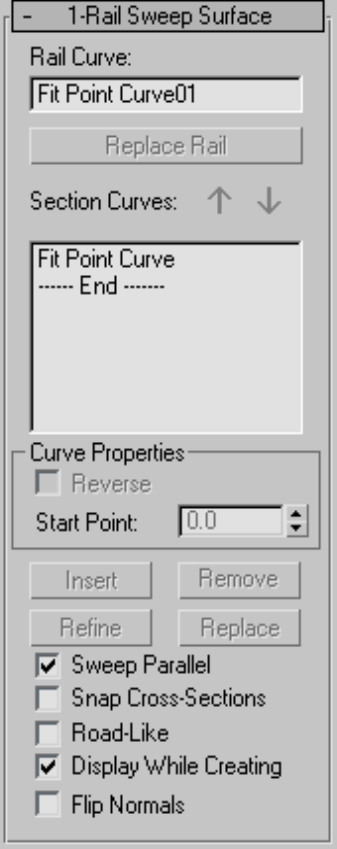
As you click curves, their names appear in the lists on the 1 Rail Sweep
Surface creation rollout. The order in which you click the curves can
affect the shape of the sweep surface.
2400 | Chapter 10 Surface Modeling

Example: To create a 1-rail sweep with automatic attach:
1From the Create panel, create two independent CV or Point NURBS curves.
2Go to the Modify panel, and click to turn on 1-Rail Sweep in the NURBS
toolbox.
3Select the curves in the appropriate order for the sweep.
The sweep is created. You don't need to collapse the curves to a NURBS
surface or Attach them to an existing NURBS model.
As you move the mouse over a curve that is not part of the active NURBS
object, the cursor changes shape to indicate that you can pick the curve,
but the curve is not highlighted in blue.
Interface
While a 1-rail sweep sub-object is selected, a rollout with the 1-rail sweep
parameters appears. This rollout appears only when one 1-rail sweep sub-object
is selected. It isn’t possible to edit more than one 1-rail sweep at a time, so
unlike some other NURBS sub-objects, the rollout doesn’t appear when multiple
1-rail sweep sub-objects are selected.
TIP When you edit a 1-rail sweep sub-object, close the Surface Common rollout
to see the 1-rail sweep Surface rollout more easily.
Creating and Editing NURBS Sub-Objects | 2401
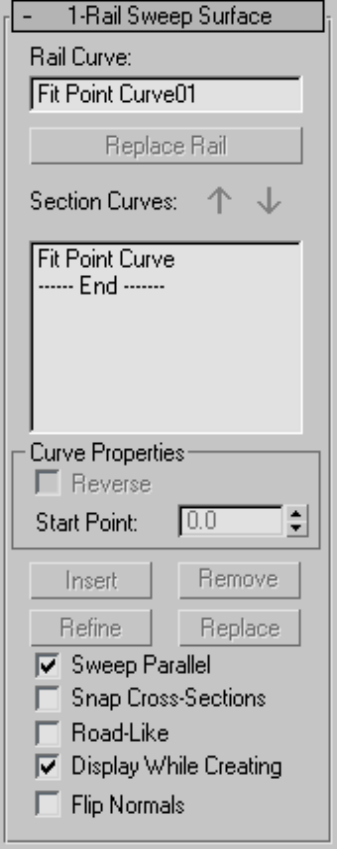
1-Rail Sweep Surface rollout (creation time)
Rail Curve Shows the name of the curve you chose to be the rail.
Replace Rail (Disabled.)
2402 | Chapter 10 Surface Modeling
Section Curves This list shows the names of the cross-section curves, in the
order you click them. You can select a curve by clicking its name in the list.
Viewports display the selected curve in blue.
Arrow Buttons Use these to change the order of section curves in the list.
Select a curve in the list, and then use the arrows to move the selection up or
down.
Curve Properties group
These controls affect individual curves you select in the Section Curves list,
as opposed to properties of the sweep surface in general. They are enabled
only when you have selected a curve in the Section Curves list.
Reverse When set, reverses the direction of the selected curve.
Start Point Adjusts the position of the curve's start point. This can help
eliminate unwanted twists or "buckles" in the surface.
This control is disabled if the curve is not a closed curve.
While you're adjusting start points, a dotted blue line is displayed between
them, to show the alignment. The surface is not displayed, so it doesn't slow
down adjustment. When you release the mouse button, the surface reappears.
Insert (Disabled.)
Remove Removes a curve from the list. Select the curve in the list, and then
click Remove.
Refine (Disabled.)
Replace (Disabled.)
Sweep Parallel When on, ensures that the sweep surface's normal is parallel
to the rail.
Snap Cross-Sections When on, cross-section curves are translated so they
intersect the rail. The first cross section is translated to the start of the rail,
and the last to the end of the rail. The cross sections in the middle are
translated to touch the rail at the closest point to the end of the cross-section
curves.
When Snap Cross-Sections is on, the sweep follows the rail curve exactly. This
makes it easier to construct 1-rail sweep surfaces.
Road-Like When on, the sweep uses a constant up-vector so the cross sections
twist uniformly as they travel along the rail. In other words, the cross sections
bank like a car following a road, or a camera following a path constraint on
page 3222 . Default=off.
Creating and Editing NURBS Sub-Objects | 2403
When you edit the surface, you can control the angle of banking. The up-vector
is displayed as a yellow gizmo (similar to the gizmo that lathe surfaces on
page 2365 use for the center of rotation). To change the up-vector angle, use
Rotate on page 889 to change the gizmo's angle.
Display While Creating When on, the sweep surface is displayed while you
create it. When off, the sweep can be created more quickly. Default=off.
Flip Normals Reverses the direction of the sweep's normals.
2404 | Chapter 10 Surface Modeling
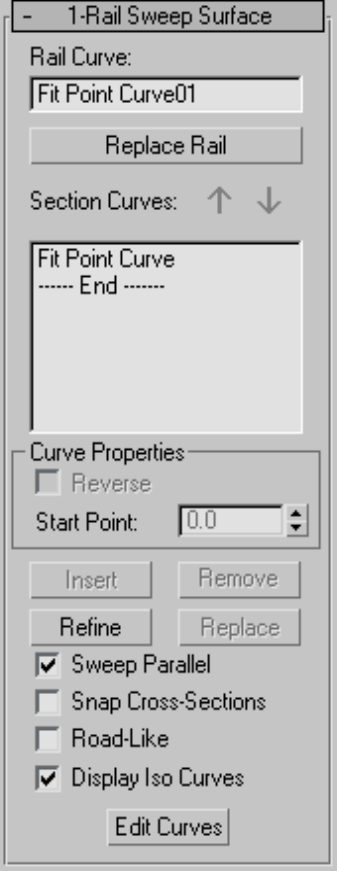
1-Rail Sweep Surface rollout (modification time)
Rail Curve Shows the name of the curve you chose to be the rail.
Creating and Editing NURBS Sub-Objects | 2405
Replace Rail Lets you replace the rail curve. Click this button, then in a
viewport click the curve to use as the new rail.
Section Curves This list shows the names of the cross-section curves, in the
order you click them. You can select a curve by clicking its name in the list.
Viewports display the selected curve in blue.
Arrow Buttons Use these to change the order of section curves in the list.
Select a curve in the list, and then use the arrows to move the selection up or
down.
Curve Properties group
These controls affect individual curves you select in the Section Curves list,
as opposed to properties of the sweep surface in general. They are enabled
only when you have selected a curve in the Section Curves list.
Reverse When set, reverses the direction of the selected curve.
Start Point Adjusts the position of the curve's start point. This can help
eliminate unwanted twists or "buckles" in the surface.
This control is disabled if the curve is not a closed curve.
While you're adjusting start points, a dotted blue line is displayed between
them, to show the alignment. The surface is not displayed, so it doesn't slow
down adjustment. When you release the mouse button, the surface reappears.
Insert Adds a curve to the section list. Click to turn on Insert, then click the
curve. The curve is inserted before the selected curve. To insert a curve at the
end, first highlight the "----End-----" marker in the list.
Remove Removes a curve from the list. Select the curve in the list, and then
click Remove.
Refine Refines the 1-rail sweep surface. Click to turn on Refine, then click
an iso curve on the surface. (As you drag the mouse over the surface, the
available section curves are highlighted.) The curve you click is converted to
a CV curve and inserted into the sweep and the section list. As when you
refine a point curve, refining a sweep can change the curvature of the surface
slightly. Once you’ve refined the surface by adding a cross-section curve, you
can use Edit Curves to change the curve.
Replace Lets you replace the selected curve. Select a curve in the list, click
this button, and then select the new curve.
Sweep Parallel When on, ensures that the sweep surface's normal is parallel
to the rail.
2406 | Chapter 10 Surface Modeling
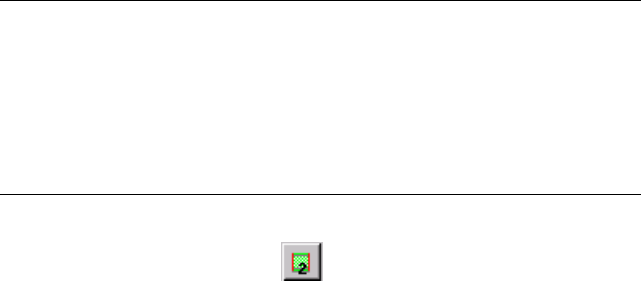
Snap Cross-Sections When on, cross-section curves are translated so they
intersect the rail. The first cross section is translated to the start of the rail,
and the last to the end of the rail. The cross sections in the middle are
translated to touch the rail at the closest point to the end of the cross-section
curves.
When Snap Cross-Sections is on, the sweep follows the rail curve exactly. This
makes it easier to construct 1-rail sweep surfaces.
Road-Like When on, the sweep uses a constant up-vector so the cross sections
twist uniformly as they travel along the rail. In other words, the cross sections
bank like a car following a road, or a camera following a path constraint on
page 3222 . Default=off.
When you edit the surface, you can control the angle of banking. The up-vector
is displayed as a yellow gizmo (similar to the gizmo that lathe surfaces on
page 2365 use for the center of rotation). To change the up-vector angle, use
Rotate on page 889 to change the gizmo's angle.
Display Iso Curves When set, the 1-rail sweep's V-axis iso curves are displayed
as well as the U-axis curves used to construct the loft. The V-axis curves are
only for display. You can’t use them for surface construction.
Edit Curves Lets you edit the currently selected curve without switching to
another sub-object level. Click to turn on Edit Curve. The points or CVs of
the curve are displayed, as well as the control lattice if the curve is a CV curve.
You can now transform or otherwise change the points or CVs as if you were
at the Point or Curve CV sub-object level. To finish editing the curve, click to
turn off Edit Curves.
TIP When you edit curves in a 1-rail sweep, turning off display of the sweep itself
can make the curves easier to see and improve performance. Use Ctrl+D (while
the Keyboard Shortcut Override Toggle on page 7646 is on) to toggle display of
dependent sub-objects, including sweeps.
The sweep surface can deviate from the curve if you edit a curve in a sweep
by increasing the weight of the curve CVs. You can work around this by
refining the curve at the point where the surface deviates.
2-Rail Sweep Surface
Select NURBS object. > Modify panel > Create Surfaces rollout > Dependent
Surfaces group box > 2-Rail
Creating and Editing NURBS Sub-Objects | 2407
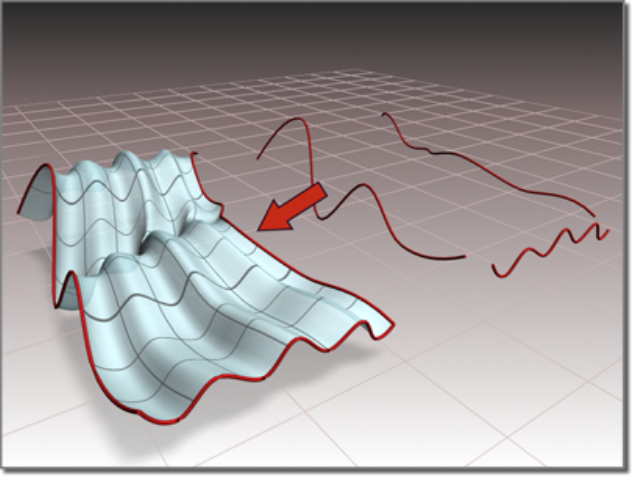
Select NURBS object. > Modify panel > NURBS toolbox > Create 2-Rail Sweep
button
Sweep surfaces are constructed from curves. A 2-rail sweep surface uses at least
three curves. Two curves, the "rails," define the two edges of the surface. The
other curves define the surface's cross sections. A 2-rail sweep surface is similar
to a 1-rail sweep. The additional rail gives you more control over the shape
of the surface.
Sweep surface created with two rails
The cross-section curves should intersect the rail curves. If the cross sections
don't intersect the rails, the resulting surface is unpredictable. In addition, the
initial points of the rails and the endpoints of the first cross-section curve
must be coincident. Use NURBS Snaps to accomplish this.
Automatic Curve Attachment
When you create a 2-rail sweep, you can select curves that are not already
sub-objects of the active NURBS model. You can select another curve or spline
object on page 542 in the scene. When you select that curve, it attaches to the
current object as if you had used the Attach button on page 2225 .
2408 | Chapter 10 Surface Modeling
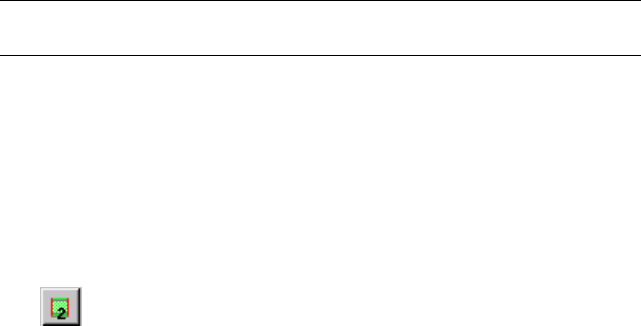
WARNING If the curve you attach is a sub-object of another NURBS model, the
entire model (that is, the curve's parent NURBS object) is attached as well.
As you move the mouse over a curve that is not part of the active NURBS
object, the cursor changes shape to indicate that you can pick the curve, but
the curve is not highlighted in blue.
Procedures
To create a 2-rail sweep:
1Create the curves that define the surface you want to create.
2 Click to turn on 2 Rail Sweep in the toolbox or on the Create
Surfaces rollout.
3Click the curve to use as the first rail, then click the curve to use as the
second rail. Click each of the cross-section curves, and then right-click
to end creation.
The sweep is interpolated smoothly between the cross sections, following
the outlines defined by the two rails.
As you click curves, their names appear in the lists on the 2 Rail Sweep
Surface creation rollout. The order in which you click the curves can
affect the shape of the sweep surface.
Example: To create a 2-rail sweep with automatic attach:
1From the Create panel, create three independent CV or Point NURBS
curves.
2Go to the Modify panel, and click to turn on 2-Rail Sweep in the NURBS
toolbox.
3Select the curves in the appropriate order for the sweep.
The sweep is created. You don't need to collapse the curves to a NURBS
surface or Attach them to an existing NURBS model.
As you move the mouse over a curve that is not part of the active NURBS
object, the cursor changes shape to indicate that you can pick the curve,
but the curve is not highlighted in blue.
Creating and Editing NURBS Sub-Objects | 2409

Interface
While a 2-rail sweep sub-object is selected, a rollout with the 2-rail sweep
parameters appears. This rollout appears only and when one 2-rail sweep
sub-object is selected. It isn’t possible to edit more than one 2-rail sweep at a
time, so unlike some other NURBS sub-objects, the rollout doesn’t appear
when multiple 2-rail sweep sub-objects are selected.
TIP When you edit a 2-rail sweep sub-object, close the Surface Common rollout
to see the 2-rail sweep surface rollout more easily.
2410 | Chapter 10 Surface Modeling
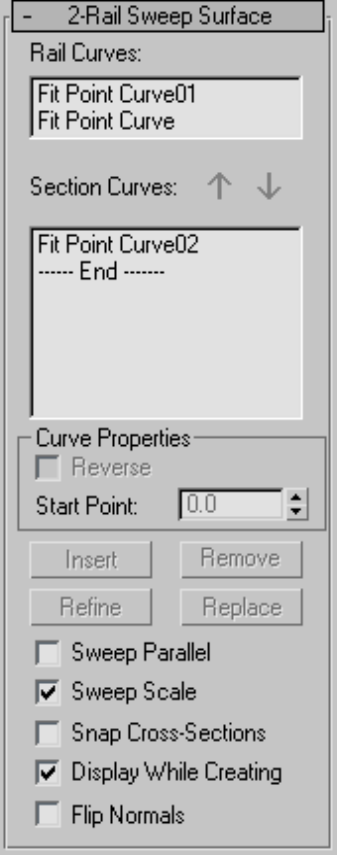
2-Rail Sweep Surface rollout (creation time)
Rail Curves Shows the names of the two curves you chose to be the rails.
Creating and Editing NURBS Sub-Objects | 2411
Section Curves This list shows the names of the cross-section curves, in the
order you click them. You can select a curve by clicking its name in the list.
Viewports display the selected curve in blue.
Arrow Buttons Use these to change the order of section curves in the list.
Select a curve in the list, and then use the arrows to move the selection up or
down.
Curve Properties group
These controls affect individual curves you select in the Section Curves list,
as opposed to properties of the sweep surface in general. They are enabled
only when you have selected a curve in the Section Curves list.
Reverse When set, reverses the direction of the selected curve.
Start Point Adjusts the position of the curve's start point. This can help
eliminate unwanted twists or "buckles" in the surface.
This control is disabled if the curve is not a closed curve.
While you're adjusting start points, a dotted blue line is displayed between
them, to show the alignment. The surface is not displayed, so it doesn't slow
down adjustment. When you release the mouse button, the surface reappears.
Insert (Disabled.)
Remove Removes a curve from the list. Select the curve in the list, and then
click Remove.
Refine (Disabled.)
Replace (Disabled.)
Sweep Parallel When off, the rail curves define a ruled surface, and the cross
sections describe lofting from this base ruled surface. When on, each cross
section is associated with its best fitting plane. This plane moves along the
rails and parallel to them. If the rails are curved, the plane can rotate. If the
spacing between the rails changes, the section scales or stretches. In either
case, the surface is blended from section to section along its entire length.
Default=off.
Sweep Scale When off, the size of the plane is scaled only in the direction
across the rails. When on, the plane is scaled uniformly in all directions.
Default=off.
Snap Cross-Sections When on, cross-section curves are translated and scaled
so they intersect both rails. The first cross section is translated to the start of
the rails, and the last to the end of the rails. The cross sections in the middle
2412 | Chapter 10 Surface Modeling
are translated to touch the rails at the closest point to the ends of the
cross-section curves. Default=off.
When Snap Cross-Sections is on, the sweep follows the rail curves exactly.
This makes it easier to construct 2-rail sweep surfaces.
Display While Creating When on, the sweep surface is displayed while you
create it. When off, the sweep can be created more quickly. Default=off.
Flip Normals Reverses the direction of the sweep's normals.
Creating and Editing NURBS Sub-Objects | 2413
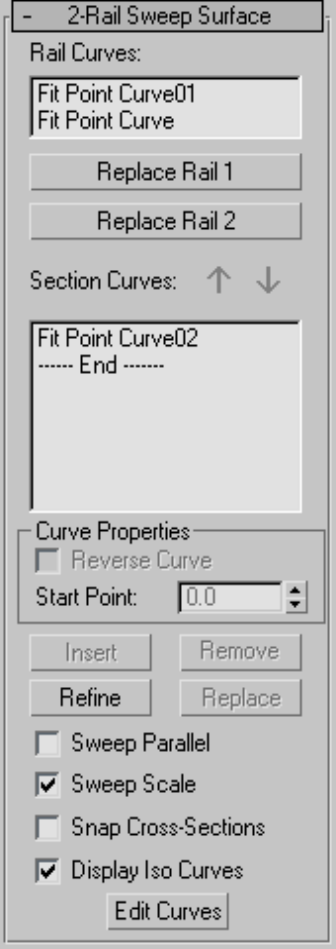
2-Rail Sweep Surface rollout (Modification time)
2414 | Chapter 10 Surface Modeling
Rail Curves Shows the names of the two curves you chose to be the rails.
Replace Rail 1 and Replace Rail 2 Let you replace the rail curves. Click one
of these buttons, then in a viewport click the curve to use as the new rail.
Section Curves This list shows the names of the cross-section curves, in the
order you click them. You can select a curve by clicking its name in the list.
Viewports display the selected curve in blue.
Arrow Buttons Use these to change the order of section curves in the list.
Select a curve in the list, and then use the arrows to move the selection up or
down.
Curve Properties group
These controls affect individual curves you select in the Section Curves list,
as opposed to properties of the sweep surface in general. They are enabled
only when you have selected a curve in the Section Curves list.
Reverse When set, reverses the direction of the selected curve.
Start Point Adjusts the position of the curve's start point. This can help
eliminate unwanted twists or "buckles" in the surface.
This control is disabled if the curve is not a closed curve.
While you're adjusting start points, a dotted blue line is displayed between
them, to show the alignment. The surface is not displayed, so it doesn't slow
down adjustment. When you release the mouse button, the surface reappears.
Insert Adds a curve to the section list. Click to turn on Insert, then click the
curve. The curve is inserted before the selected curve. To insert a curve at the
end, first highlight the "----End-----" marker in the list.
Remove Removes a curve from the list. Select the curve in the list, and then
click Remove.
Refine Refines the 2-rail sweep surface. Click to turn on Refine, then click
an iso curve on the surface. (As you drag the mouse over the surface, the
available section curves are highlighted.) The curve you click is converted to
a CV curve and inserted into the sweep and the section list. As when you
refine a point curve, refining a sweep can change the curvature of the surface
slightly. Once you’ve refined the surface by adding a cross-section curve, you
can use Edit Curves to change the curve.
Replace Lets you replace the selected curve. Select a curve in the list, click
this button, then select the new curve.
Creating and Editing NURBS Sub-Objects | 2415

Sweep Parallel When off, the rail curves define a ruled surface, and the cross
sections describe lofting from this base ruled surface. When on, each cross
section is associated with its best fitting plane. This plane moves along the
rails and parallel to them. If the rails are curved, the plane can rotate. If the
spacing between the rails changes, the section scales or stretches. In either
case, the surface is blended from section to section along its entire length.
Default=off.
Sweep Scale When off, the size of the plane is scaled only in the direction
across the rails. When on, the plane is scaled uniformly in all directions.
Default=off.
Snap Cross-Sections When on, cross-section curves are translated and scaled
so they intersect both rails. The first cross section is translated to the start of
the rails, and the last to the end of the rails. The cross sections in the middle
are translated to touch the rails at the closest point to the ends of the
cross-section curves. Default=off.
When Snap Cross-Sections is on, the sweep follows the rail curves exactly.
This makes it easier to construct 2-rail sweep surfaces.
Display Iso Curves When set, the 2-Rail Sweep's V-axis iso curves are displayed
as well as the U-axis curves used to construct the sweep. The V-axis curves are
only for display. You can’t use them for surface construction.
Edit Curves Lets you edit the currently selected curve without switching to
another sub-object level. Click to turn on Edit Curve. The points or CVs of
the curve are displayed, as well as the control lattice if the curve is a CV curve.
You can now transform or otherwise change the points or CVs as if you were
at the Point or Curve CV sub-object level. To finish editing the curve, click to
turn off Edit Curves.
TIP When you edit curves in a 2-rail sweep, turning off display of the sweep itself
can make the curves easier to see and improve performance as well. Use Ctrl+D
(while the Keyboard Shortcut Override Toggle on page 7646 is on) to toggle display
of dependent sub-objects, including sweeps.
The sweep surface can deviate from the curve if you edit a curve in a sweep
by increasing the weight of the curve CVs. You can work around this by
refining the curve at the point where the surface deviates.
2416 | Chapter 10 Surface Modeling
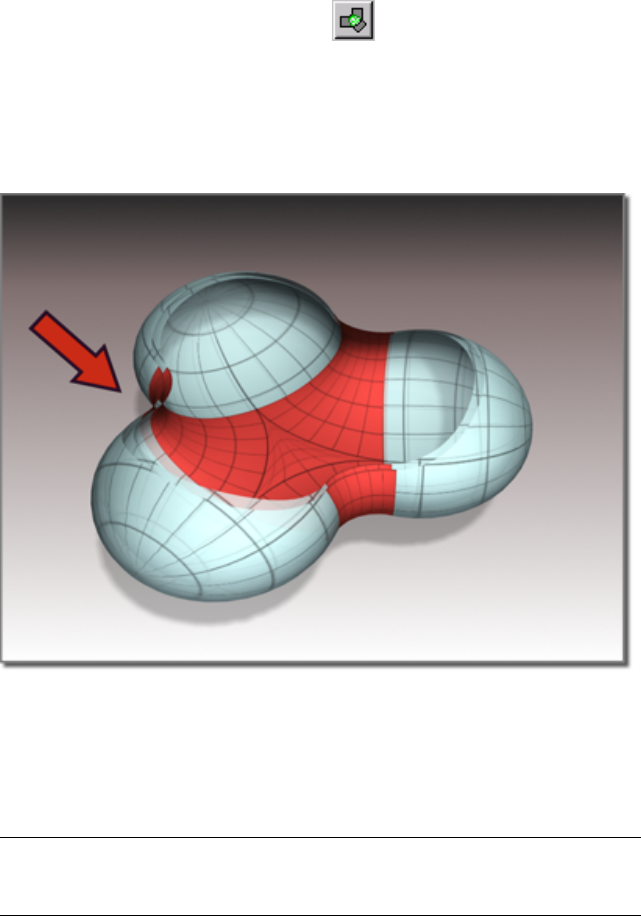
Multisided Blend Surface
Select NURBS object. > Modify panel > Create Surfaces rollout > Dependent
Surfaces group box > N Blend
Select NURBS object. > Modify panel > NURBS toolbox > Create a Multisided
Blend Surface button
Multisided blend between three other surfaces
A multisided blend surface "fills in" the edges defined by three or four other
curve or surface sub-objects. Unlike a regular, two-sided blend surface, the
curves’ or surfaces’ edges must form a closed loop; that is, they must completely
surround the opening that the multisided blend will cover.
TIP If the multisided blend surface can't be created, fuse the points or CVs at the
corners where the surfaces meet. Sometimes snapping the corners doesn't work,
because of round-off error.
Creating and Editing NURBS Sub-Objects | 2417
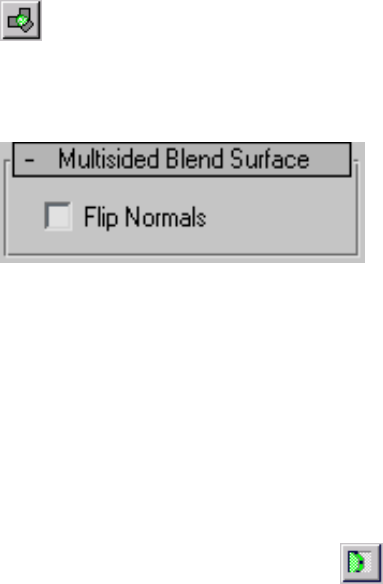
Procedures
To create a multisided blend:
1 Click to turn on Multisided Blend in the toolbox or N Blend on the
Create Surfaces rollout.
2In turn, click the three or four surface sides or curves that surround the
opening.
You can flip normals on the multisided blend while creating it.
3Right-click to end creation.
A new surface is created. It covers the opening.
Interface
Multisided Blend surfaces have no parameters other than those on the Surface
Common rollout on page 2264 .
Multicurve Trimmed Surface
Select NURBS object. > Modify panel > Create Surfaces rollout > Dependent
Surfaces group box > Multi-Trim
Select NURBS object. > Modify panel > NURBS toolbox > Create a Multicurve
Trimmed Surface button
2418 | Chapter 10 Surface Modeling
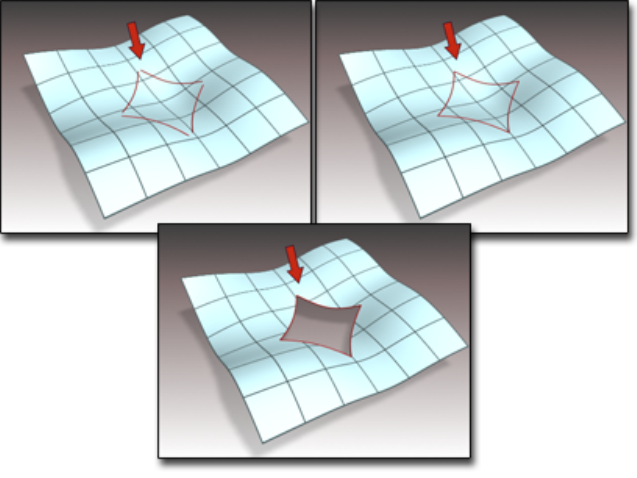
Creating a multicurve trimmed surface
A multicurve trimmed surface is an existing surface trimmed by multiple
curves that form a loop.
When you create a multicurve trimmed surface, you create only one trimmed
hole. If you want to create multiple holes, first create holes in the surface using
other techniques, and as the final step create the multicurve trim.
You can't trim across the edge between two surfaces, or across a "seam" where
a surface touches itself, as at the back of a spherical surface created by
converting a Sphere primitive.
Procedures
To create a multicurve trim:
1Create a loop out of multiple curve sub-objects.
2At the Curve CV or Point sub-object level, use Fuse to connect the ends
of the curves.
The curves must form a single closed loop, or completely traverse the
surface.
Creating and Editing NURBS Sub-Objects | 2419
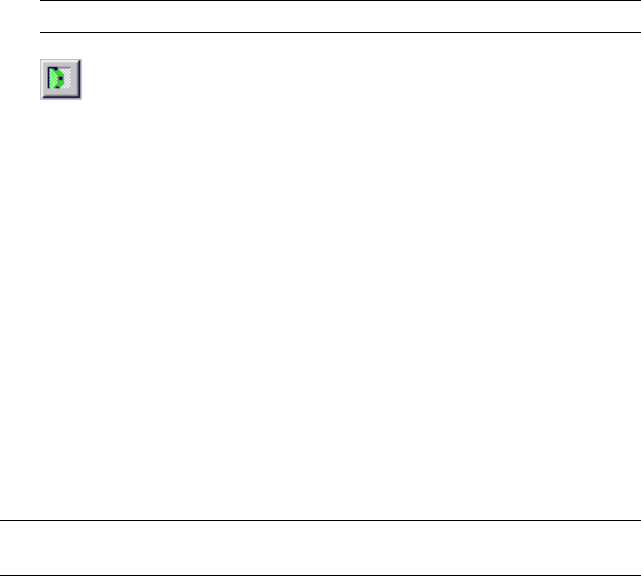
3Project the curves onto the surface by creating a normal or vector
projected curve for each curve in the loop.
TIP You can also use CV or point curve on surface for these curves.
4 Turn on Multicurve Trimmed Surface in the toolbox or Multi-Trim
on the Create Surfaces rollout.
5Click the surface to trim, then click each of the curves in the loop.
Right-click to end creation.
The Trim list shows the names of the curves you select. Flip Trim inverts
the direction of trimming. Flip Normals lets you flip the surface normals
at creation time. (After you have created the surface, you can flip normals
using controls on the Surface Common rollout.)
Interface
While a multicurve trimmed sub-object is selected, a rollout with the
multicurve trim parameters appears. This rollout appears only when one
multicurve trimmed sub-object is selected. It isn’t possible to edit more than
one multicurve trimmed object at a time, so unlike some other NURBS
sub-objects, the rollout doesn’t appear when multiple multicurve trimmed
sub-objects are selected.
TIP When you edit a multicurve trimmed sub-object, close the Surface Common
rollout to see the Multicurve Trim Surface rollout more easily.
2420 | Chapter 10 Surface Modeling
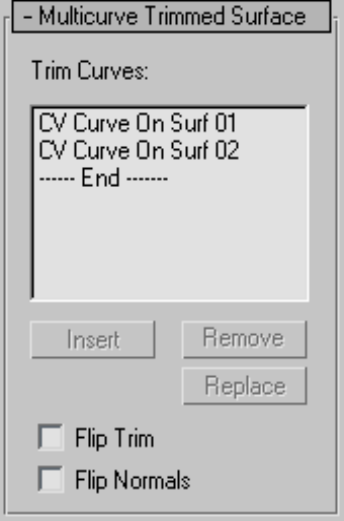
Multicurve Trimmed Surface rollout (creation time)
Trim Curves This list shows the names of the curves used to trim the surface.
You can select a curve by clicking its name. Viewports display the selected
curve in blue.
Insert (Disabled.)
Remove Removes a curve from the list. Select the curve in the list, and then
click Remove.
Replace (Disabled.)
Flip Trim Reverses the direction of the trim.
Flip Normals Turn on to reverse the direction of the trimmed surface's
normals.
Creating and Editing NURBS Sub-Objects | 2421
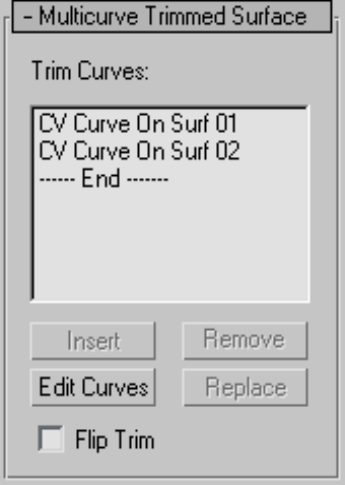
Multicurve Trimmed Surface rollout (modification time)
Trim Curves This list shows the names of the curves used to trim the surface.
You can select a curve by clicking its name. Viewports display the selected
curve in blue.
Insert Adds a curve to the Trim Curves list. Click to turn on Insert, then
click the curve. The curve is inserted before the selected curve. To insert a curve
at the end, first highlight the "----End-----" marker in the list.
Remove Removes a curve from the list. Select the curve in the list, and then
click Remove.
Edit Curves Lets you edit the currently selected curve without switching to
another sub-object level. Click to turn on Edit Curve. The points or CVs of
the curve are displayed, as well as the control lattice if the curve is a CV curve.
You can now transform or otherwise change the points or CVs as if you were
at the Point or Curve CV sub-object level. To finish editing the curve, click to
turn off Edit Curves.
Don't edit the curve so you break the loop. If you do, the surface goes into an
error condition.
2422 | Chapter 10 Surface Modeling
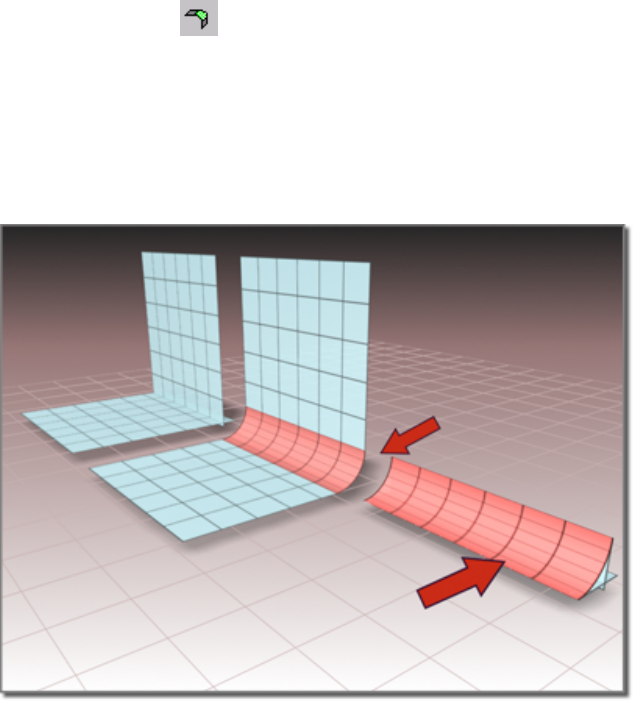
Replace Lets you replace the selected curve. Select a curve in the list, click
this button, and then select the new curve.
Flip Trim Reverses the direction of the trim.
Along with Edit Curves, the Insert, Remove, and Replace buttons let you alter
the curves that trim the surface. While you are making changes, the surface
will go into an error condition (orange display by default) until the curves
you are working on once again form a closed loop.
Fillet Surface
Select NURBS object. > Modify panel > Create Surfaces rollout > Dependent
Surfaces group box > Fillet Surf
Select NURBS object. > Modify panel > NURBS toolbox > Create Fillet Surface
button
A fillet surface is a rounded corner connecting the edges of two other surfaces.
Fillet surface created from two parent surfaces
Creating and Editing NURBS Sub-Objects | 2423

Usually you use both edges of the fillet surface to trim the parent surfaces,
creating a transition between the fillet and its parents.
Procedures
To create a fillet surface:
1 In a NURBS object, turn on Fillet on the Create Surfaces rollout or
Create Fillet Surface in the toolbox.
2Click to choose the first parent surface, then click to choose the second
parent surface. Potential parent surfaces are highlighted in blue as you
move the mouse in a viewport.
The fillet surface is created. If the fillet surface can't be created, a default
error surface is displayed (by default, the error surface displays as orange).
2424 | Chapter 10 Surface Modeling
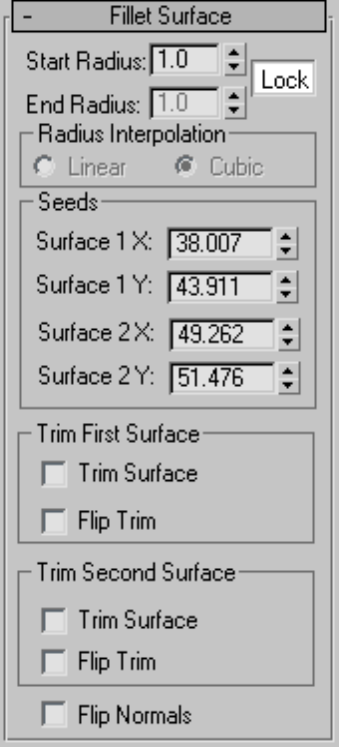
Interface
Fillet Surface rollout (creation time)
Start Radius and End Radius Set the radius used to define the fillet at the
first surface you chose and the second surface you chose, respectively. The
radiuses control the size of the fillet surface. Default=1.0.
Lock Locks the Start and End radius values so they are identical. When on,
the End Radius setting is unavailable. Default=on.
Creating and Editing NURBS Sub-Objects | 2425
Radius Interpolation group
This group box controls the radius of the fillet. The Radius Interpolation setting
has no effect unless one or both surfaces that define the fillet have curvature
to them.
Linear When chosen (the default), the radius is linear.
Cubic When chosen, the radius is treated as a cubic function, allowing it to
change based on the parent surface's geometry.
Seeds group
These spinners adjust the seed values for the fillet surface. If there is more
than one way to construct the fillet, the software uses the seed values to choose
the nearest edge for that surface.
Surface 1 X Sets the local X coordinate of the seed on the first surface you
chose.
Surface 1 Y Sets the local Y coordinate of the seed on the first surface you
chose.
Surface 2 X Sets the local X coordinate of the seed on the second surface
you chose.
Surface 2 Y Sets the local Y coordinate of the seed on the second surface you
chose.
Trim First Surface and Trim Second Surface groups
For each of the parent surfaces, these controls affect trimming.
Trim Surface Trims the parent surface at the edge of the fillet.
Flip Trim Reverses the direction of the trim.
Flip Normals Turn on to reverse the direction of the fillet surface's normals.
2426 | Chapter 10 Surface Modeling
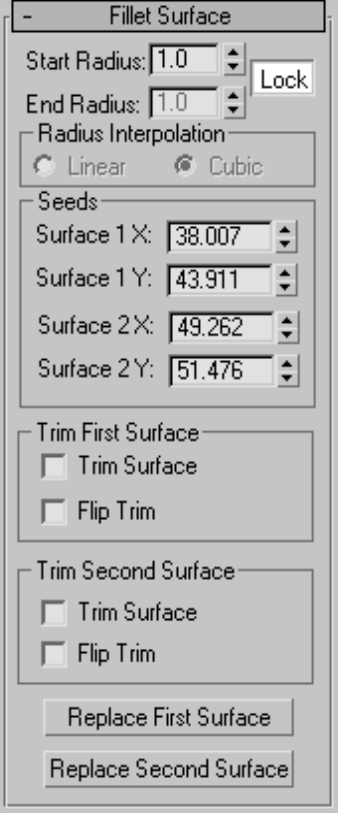
Fillet Surface rollout (modification time)
Start Radius and End Radius Set the radius used to define the fillet at the
first surface you chose and the second surface you chose, respectively. The
radiuses control the size of the fillet surface. Default=10.0.
Lock Locks the Start and End radius values so they are identical. When on,
the End Radius setting is unavailable. Default=on.
Creating and Editing NURBS Sub-Objects | 2427
Radius Interpolation group
This group box controls the radius of the fillet. The Radius Interpolation setting
has no effect unless one or both surfaces that define the fillet have curvature
to them.
Linear When chosen (the default), the radius is always linear.
Cubic When chosen, the radius is treated as a cubic function, allowing it to
change based on the parent surface's geometry.
Seeds group
These spinners adjust the seed values for the fillet surface. If there is more
than one way to construct the fillet, the software uses the seed values to choose
the nearest edge for that surface.
Surface 1 X Sets the local X coordinate of the seed on the first surface you
chose.
Surface 1 Y Sets the local Y coordinate of the seed on the first surface you
chose.
Surface 2 X Sets the local X coordinate of the seed on the second surface
you chose.
Surface 2 Y Sets the local Y coordinate of the seed on the second surface you
chose.
Trim First Surface and Trim Second Surface groups
For each of the parent surfaces, these controls affect trimming.
Trim Surface Trims the parent surface at the edge of the fillet.
Flip Trim Reverses the direction of the trim.
Replace First Surface and Replace Second Surface Let you replace the parent
surfaces. Click a button, then click the surface to replace the original first or
second surface.
Creating and Editing Point Sub-Objects
Select NURBS object. > Modify panel > Create Points rollout
Select NURBS object. > Modify panel > NURBS toolbox
2428 | Chapter 10 Surface Modeling
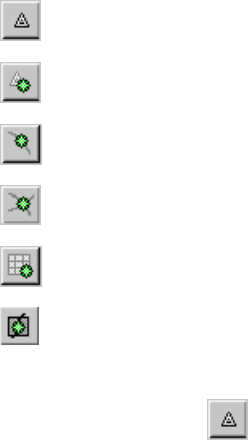
Keyboard > Ctrl+T to toggle NURBS toolbox display (Keyboard Shortcut
Override Toggle must be on.)
In addition to the points that are an integral part of point curve on page 2201
and point surface on page 2192 objects, you can create "freestanding" points.
Such points can help you construct point curves by using the Curve Fit on
page 2293 button. You also use dependent points to trim curves.
You create individual points as NURBS sub-objects while you are modifying
NURBS. To create points individually, use the Create Points rollout or the
NURBS toolbox on page 2162 .
Toolbox Buttons for Creating Points
These are the toolbox buttons for creating point sub-objects:
Create an independent point on page 2429 .
Create a dependent offset point on page 2430 .
Create a dependent curve point on page 2432 .
Create a dependent curve-curve intersection point on page 2438 .
Create a dependent surface point on page 2435 .
Create a dependent surface-curve intersection point on page 2441 .
Point (NURBS)
Select NURBS object. > Modify panel > Create Points rollout > Point button
Select NURBS object. > Modify panel > NURBS toolbox > Create Point button
This command creates an independent, freestanding point.
Creating and Editing NURBS Sub-Objects | 2429

Procedures
To create a freestanding point:
1Select a NURBS object.
2In the Modify > Create Points rollout, turn on Point.
3Click a viewport to position the point.
Independent point sub-objects have no additional parameters. You can use
Curve Fit in the Create Curves rollout to create a curve from multiple
freestanding points.
Interface
There are no additional controls for independent points.
Offset Point
Select NURBS object. > Modify panel > Create Points rollout > Dependent
Points group box > Offset Point button
Select NURBS object. > Modify panel > NURBS toolbox > Create Offset Point
button
This command creates a dependent point that is coincident to an existing
point or at a relative distance from an existing point.
Procedures
To create a dependent offset point:
1Select a NURBS object
2On the Modify > Create Points rollout, turn on Offset Point.
3In a viewport, click an existing point.
4In the Modify > Offset Points rollout, use the Offset spinners to adjust
the point’s position relative to the original point.
2430 | Chapter 10 Surface Modeling
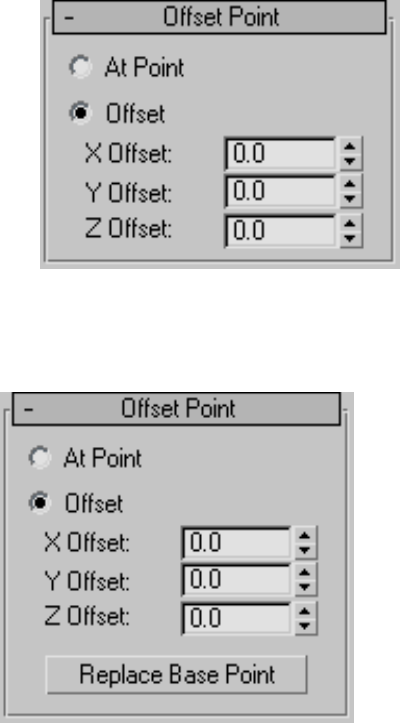
Interface
While an offset point sub-object is selected, the Offset Point rollout appears.
At Point When chosen, the dependent point has the same location as the
original, parent point.
Offset Enables point offset. Use the X,Y,Z Offset spinners to set offset values
(in object space coordinates).
Replace Base Point (Only at modification time.) Lets you replace the parent
point. Click the button, then click the new point on which to base the offset
point.
Creating and Editing NURBS Sub-Objects | 2431

Curve Point
Select NURBS object. > Modify panel > Create Points rollout > Dependent
Points group box > Curve Point button
Select NURBS object. > Modify panel > NURBS toolbox > Create Curve Point
button
This command creates a dependent point that lies on a curve or relative to it.
The point can be either on the curve or off the curve. If it is on the curve, the
U Position is the only control of its location. The U Position specifies a location
along the curve (based on the curve's local U axis). There are three ways to
displace the point's location relative to the U position.
Procedures
To create a dependent curve point:
1Turn on Curve Point and then click along a curve to position the point.
2The curve and cursor position are highlighted during this operation.
3At the Point sub-object level, adjust the point's position relative to the
curve by adjusting the curve point parameters on the Curve Point rollout.
2432 | Chapter 10 Surface Modeling
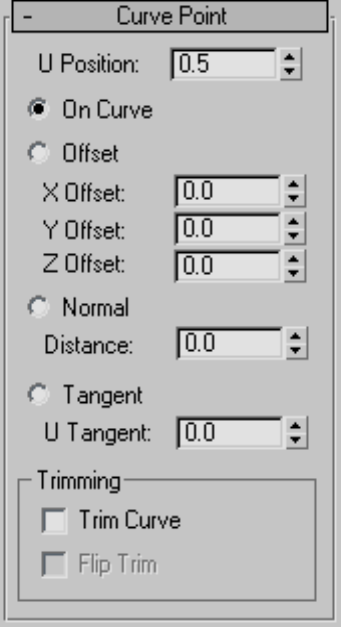
4Right-click to end operation.
Interface
While a curve point sub-object is selected, the Curve Point rollout appears.
Creating and Editing NURBS Sub-Objects | 2433
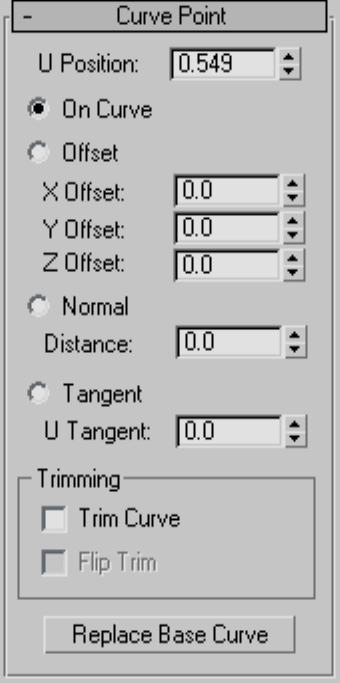
U Position Specifies the point's location on the curve or relative to the curve.
On Curve When on, the point lies on the curve at the U Position.
Offset Moves the point according to a relative (object space) X,Y,Z location.
This is relative to the U Position.
X Offset, Y Offset, and Z Offset Specify the object space location of the offset
curve point.
Normal Moves the point along the direction of the curve's normal at the U
Position.
Distance Specifies the distance along the curve's normal. Negative values
move the point opposite to the normal.
2434 | Chapter 10 Surface Modeling
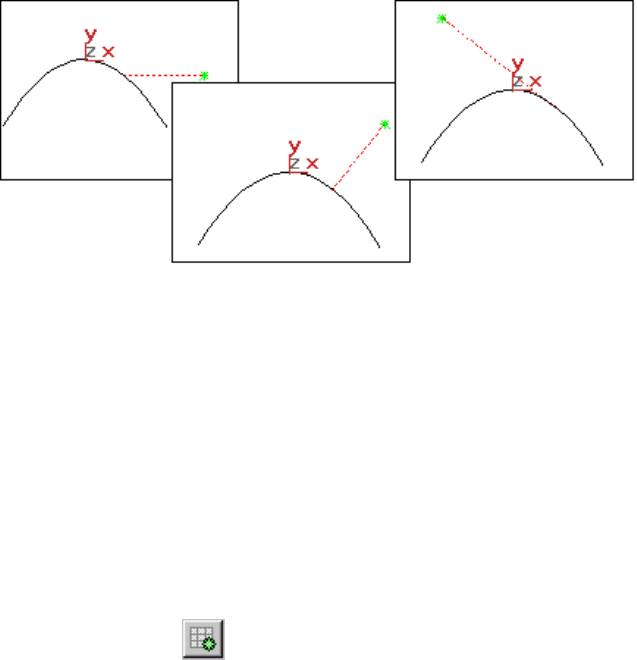
Tangent Moves the point along the tangent at the U Position.
U Tangent Specifies the distance from the curve along the tangent.
Offset, normal, and tangent displacement of a curve point
Trimming group box
Controls in this group box let you trim the parent curve.
Trim Curve When on, trims the parent curve against the curve point's U
position. When off (the default), the parent isn't trimmed.
Flip Trim When on, trims in the opposite direction.
Replace Base Curve (Only at modification time.) Lets you replace the parent
curve. Click the button, then click the new curve on which to base the curve
point.
Surface Point
Select NURBS object. > Modify panel > Create Points rollout > Dependent
Points group box > Surface Point button
Select NURBS object. > Modify panel > NURBS toolbox > Create Surf Point
button
This command creates a dependent point that lies on a surface or relative to
it. This is enabled with a NURBS object that contains a surface.
Creating and Editing NURBS Sub-Objects | 2435
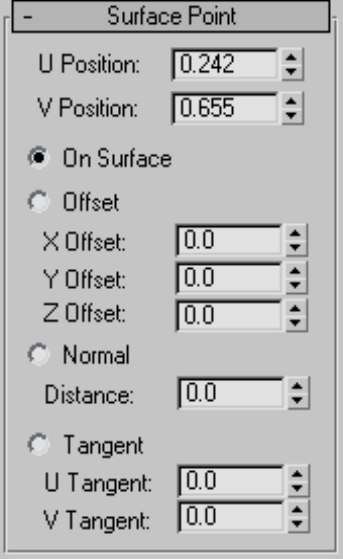
Procedures
To create a dependent surface point:
1Turn on Surf Point and then click over a NURBS surface to position the
point.
2The surface cross-section and cursor are highlighted during this operation.
3Right-click to end the create operation.
4At the Point sub-object level, adjust the point’s position relative to the
surface by adjusting the surface point parameters in the Surface Point
rollout.
Interface
While a surface point sub-object is selected, the Surface Point rollout appears.
These controls are similar to the curve point controls.
2436 | Chapter 10 Surface Modeling
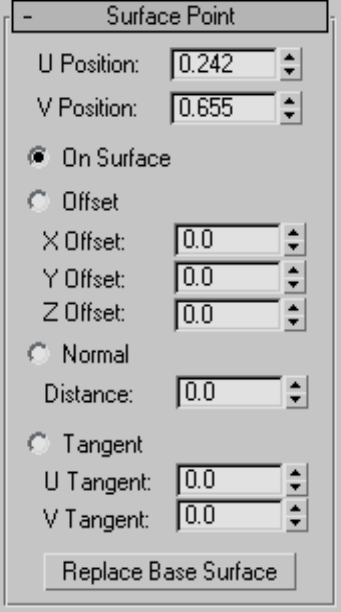
U Position and V Position If the point is on the surface, these coordinates
specify the point's location, based on the surface's local UV coordinates.
On Surface Specifies that the point lies on the surface, at the location
specified by U Position and V Position.
If the point lies on the surface, you can move it using the Move transform.
You can also move it using the Move Surface Point button. See Editing Point
Sub-Objects on page 2231 . Either way, this updates the U Position and V Position
values.
Offset Moves the point according to a relative (object space) X,Y,Z location.
X Offset, Y Offset, and Z Offset Specify the object space location of the offset
surface point.
Normal Moves the point along the direction of the surface's normal.
Creating and Editing NURBS Sub-Objects | 2437

Distance Specifies the distance from the surface, along the normal. Negative
values move the point opposite to the normal.
Tangent Moves the point along the tangent of the UV position.
U Tangent and V Tangent Specify the distance from the surface along the
tangents at U and V.
Replace Base Surface (Only at modification time.) Lets you replace the parent
surface. Click the button, then click the new surface on which to base the
surface point.
Curve-Curve Intersection Point
Select NURBS object. > Modify panel > Create Points rollout Dependent Points
group box > Curve-Curve button
Select NURBS object. > Modify panel > NURBS toolbox > Create Curve-Curve
Point button
This command creates a dependent point at the intersection of two curves.
Procedures
To create a dependent curve-curve point:
1Turn on Curve-Curve, then drag from the first curve to the second.
If the curves do not intersect, the point is orange, an invalid dependent
point.
The point is created at the nearest intersection between the two curves.
You can use the curve-curve parameters to trim the parent curves.
2Right-click to end the create operation.
2438 | Chapter 10 Surface Modeling
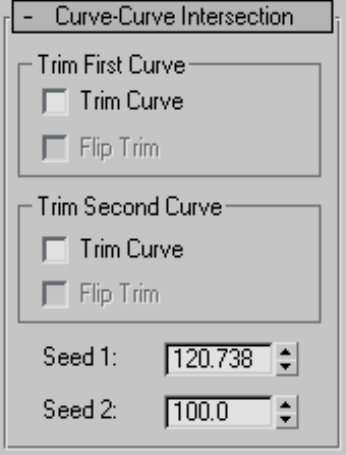
Interface
While a curve-curve point sub-object is selected, the Curve-Curve Intersection
rollout appears.
Creating and Editing NURBS Sub-Objects | 2439
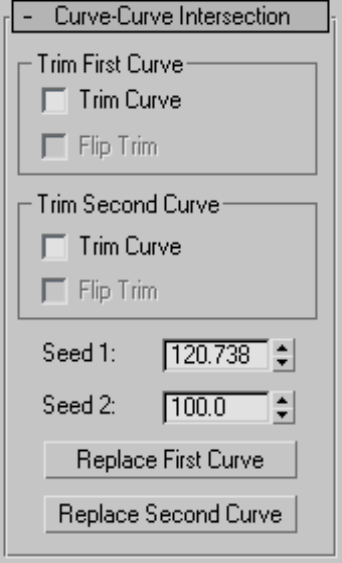
Trim First Curve and Trim Second Curve groups
These two groups let you control how the parent curves are trimmed. The
controls are the same in each. "First" and "second" refer to the order in which
you picked the parent curves.
Trim Curve When on, the parent curve is trimmed against the curve-curve
point. When off (the default), the parent isn't trimmed.
Flip Trim When on, trims in the opposite direction.
Seed 1 and Seed 2 Change the U location of the seed value on the first and
second curves. If there is a choice of intersections, the intersection closest to
the seed points is the one used to create the point.
Replace First Curve and Replace Second Curve (Only at modification time.)
Let you replace the parent curves. Click a button, then click the curve to
replace the original first or second curve.
2440 | Chapter 10 Surface Modeling
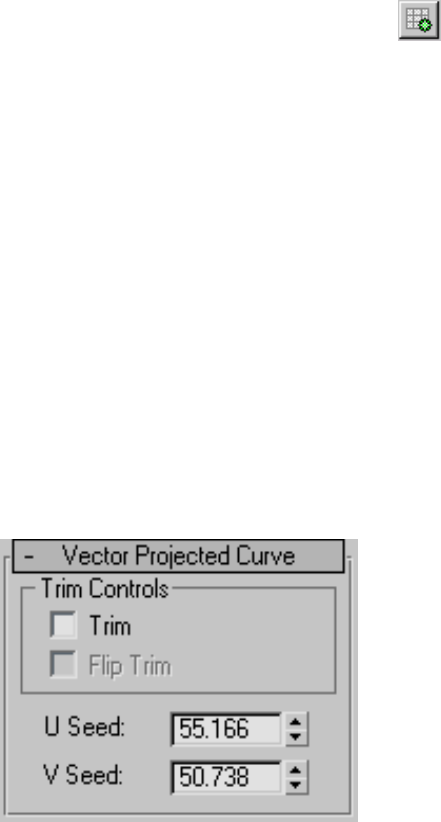
Surface-Curve Intersection Point
Select NURBS object. > Modify panel > Create Points rollout > Dependent
Points group box > Surf-Curve button
Select NURBS object. > Modify panel > NURBS toolbox > Create Surface-Curve
Point button
This command creates a dependent point at the intersection of a surface and
a curve.
Procedures
To create a dependent surface-curve point:
1In a NURBS object that has a curve that passes through a surface, click
to turn on Create Surface Curve Point in the NURBS toolbox or Surf-Curve
on the Create Points rollout.
2Click the curve, then click the surface.
The point is created at the nearest intersection between the curve and
the surface that is nearest the seed point. You can use the surface-curve
parameters to trim the parent curve.
Interface
While a surface-curve intersection point sub-object is selected, a rollout with
its parameters appears.
Creating and Editing NURBS Sub-Objects | 2441
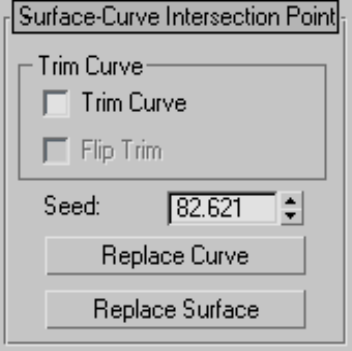
Trim Curve group
Trim When on, trims the curve from the surface. When off, the curve isn’t
trimmed.
Flip Trim When on, trims the curve in the opposite direction.
Seed Changes the U location of the seed value on the curve. If there is a
choice of intersections, the intersection closest to the seed point is the one
used to create the point.
Replace Curve and Replace Surface (Only at modification time.) Let you
replace the parent sub-objects. Click a button, then click a curve or surface to
replace the original parent object.
NURBS Editing Dialogs
Convert Curve Dialog
Modify panel > Select NURBS curve sub-object. > Curve Common rollout >
Convert Curve button
This dialog is a general way to convert one kind of a curve to another or to
adjust a curve's parameters.
2442 | Chapter 10 Surface Modeling
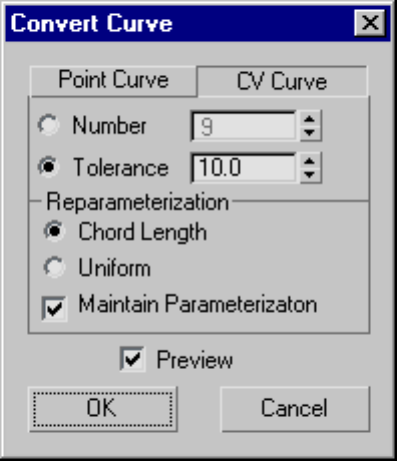
Interface
Point Curve and CV Curve Choose whether to convert to a point curve or a
CV curve. If the curve is already of the type you chose, the settings in this
dialog don't convert it, but do change its properties. Default=CV Curve.
CV Curve options
These are the options when you choose CV Curve.
Number When chosen, the spinner sets the number of CVs in the CV curve.
Tolerance When chosen, the software calculates the number of CVs. This
option rebuilds the curve according to accuracy. The lower the Tolerance
value, the more accurate the rebuild. Increasing Tolerance enables the curve
to be rebuilt using fewer CVs.
Reparameterization group
These controls let you reparameterize the CV curve and turn on automatic
reparameterization.
Chord Length Chooses the chord-length algorithm for reparameterization.
Creating and Editing NURBS Sub-Objects | 2443
Chord-length reparameterization spaces knots (in parameter space on page
7882 ) based on the square root of the length of each curve segment.
Chord-length reparameterization is usually the best choice.
Uniform Spaces the knots uniformly.
A uniform knot vector has the advantage that the curve changes only locally
when you edit it. With chord-length parameterization, moving any CV can
potentially change the entire sub-object.
Maintain Parameterization When on, the curve is automatically
reparameterized as you edit it, using the currently active method of
reparameterization. When off, no reparameterization happens unless you use
a dialog to specifically request it. Default=on.
Point Curve options:
These are the options when you choose Point Curve.
Number Sets the number of points in the point curve.
Tolerance When chosen, the software calculates the number of points. This
option rebuilds the curve according to accuracy. The lower the Tolerance
value, the more accurate the rebuild. Increasing Tolerance enables the curve
to be rebuilt using fewer points.
Preview When on, the effect of the conversion is previewed in viewports.
Default=on.
Convert Curve on Surface Dialog
Modify panel > Select NURBS object. > Stack display > Curve sub-object level
> Select curve sub-object. > Curve Common rollout > Make COS button
This dialog converts a curve to a point curve on surface on page 2331 or CV
curve on surface on page 2327 . The Make COS button that displays it is enabled
only for the following types of curves:
■U iso curves on page 2318
■V iso curves on page 2318
■Normal projected curves on page 2320
■Vector projected curves on page 2323
2444 | Chapter 10 Surface Modeling
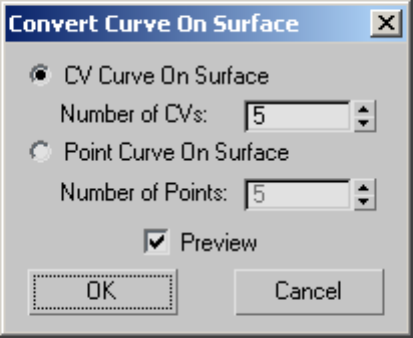
■Surface-surface intersection curves on page 2312
■Surface edge curves on page 2335
■CV curves on surfaces on page 2327
■Point curves on surfaces on page 2331
If the curve is already a curve on surface, this dialog lets you change its type.
Interface
CV Curve on Surface Converts the curve to a CV curve on surface.
Number of CVs Specifies the number of CVs in the new curve.
Point Curve on Surface Converts the curve to a point curve on surface.
Number of Points Specifies the number of points in the new curve.
Preview When on, previews the effect of the conversion in viewports.
Default=on.
Convert Surface Dialog
Modify panel > Select NURBS surface sub-object. > Surface Common rollout
> Convert Surface button
This dialog provides a general way to convert one kind of a surface to another
or to adjust a surface's parameters.
Creating and Editing NURBS Sub-Objects | 2445
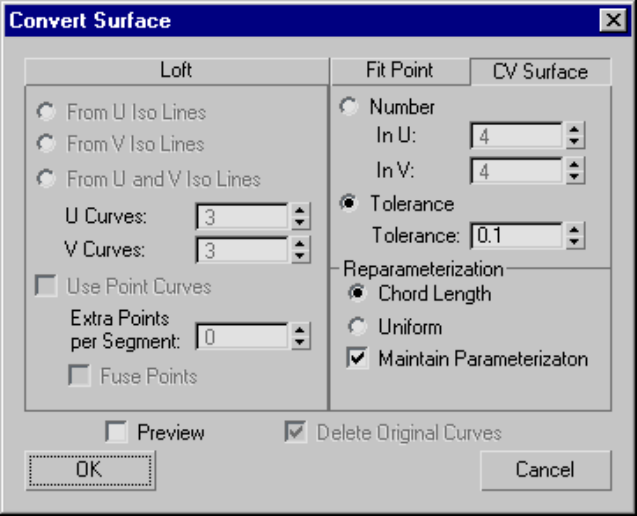
Interface
Loft tab
If the surface isn't already a loft, this tab converts it to the kind of loft you
indicate.
The controls are comparable to those in the Make Loft dialog on page 2459 .
From U Iso Lines Uses curves along the surface's U dimension to construct
a U loft.
From V Iso Lines Uses curves along the surface's V dimension to construct
a U loft. If the surface was already a U loft, set this to change the lofting
dimension.
From U and V Iso Lines Uses curves from both the U and V dimensions to
construct a UV loft.
U Curves Sets the number of curves in U.
V Curves Sets the number of curves in V.
2446 | Chapter 10 Surface Modeling
Use Point Curves When on, constructs the loft from point curves instead of
the default CV curves. Default=off.
Extra Points per Segment This control is available only for UV lofts (From
U and V Iso Lines). Lets you increase the number of points in each segment.
Fuse Points This control is available only for UV lofts (From U and V Iso
Lines). When on, fuses points at curve intersections to ensure that the U and
V curves continue to intersect when you edit the surface, and that the surface
remains coincident with its parent curves. UV lofts constructed from
intersecting curves behave more predictably. Default=on.
Fit Point tab
If the surface isn't already a point surface, this tab converts it to a point surface.
In U Sets the number of point rows (in the surface's U axis).
In V Sets the number of point columns (in the surface's V axis).
Tolerance When chosen, the software calculates the number of points. This
option rebuilds the surface according to accuracy. The lower the Tolerance
value, the more accurate the rebuild. Increasing Tolerance enables the surface
to be rebuilt using fewer points.
CV Surface tab
If the surface isn't already a CV surface, this tab converts it to a CV surface.
This tab is the default.
Number When chosen, the spinners set the number of CVs in the CV surface.
In U Sets the number of CV rows (in the surface's U axis).
In V Sets the number of CV columns (in the surface's V axis).
Tolerance When chosen, the software calculates the number of CVs. This
option rebuilds the surface according to accuracy. The lower the Tolerance
value, the more accurate the rebuild. Increasing Tolerance enables the surface
to be rebuilt using fewer CVs.
Reparameterization group
These controls let you reparameterize the CV surface and turn on automatic
reparameterization.
Chord Length Chooses the chord-length algorithm for reparameterization.
Creating and Editing NURBS Sub-Objects | 2447
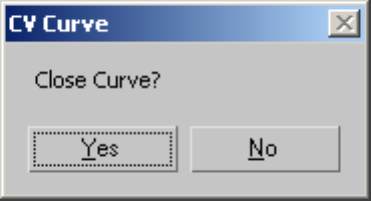
Chord-length reparameterization spaces knots (in parameter space on page
7882 ) based on the square root of the length of each segment.
Chord-length reparameterization is usually the best choice.
Uniform Spaces the knots uniformly.
A uniform knot vector has the advantage that the surface changes only locally
when you edit it. With chord-length parameterization, moving any CV can
potentially change the entire surface.
Maintain Parameterization When on, the surface is automatically
reparameterized as you edit it, using the currently active method of
reparameterization. When off, no reparameterization happens unless you use
a dialog to specifically request it. Default=on.
Preview When on, viewports display a preview of the conversion. Turning
off this toggle can speed up conversion, especially to lofts.
Delete Original Curves This is available only if the surface was already a U
loft or UV loft. When on, Convert Surface deletes the original loft curves when
you click OK. When off, the original curves remain where they are. Default=off.
CV Curve: Close Curve Dialog
Create panel > Shapes button > CV Curve button > In viewports, draw a CV
curve and click to create a CV in the same location as the first CV in the curve.
Modify panel > Select NURBS object. > NURBS toolbox > Create CV Curve >
In viewports, draw a CV curve sub-object and click to create a CV in the same
location as the first CV in the curve.
This dialog lets you create a closed CV curve when you click to create a CV in
the same location as the curve's first CV.
Interface
2448 | Chapter 10 Surface Modeling
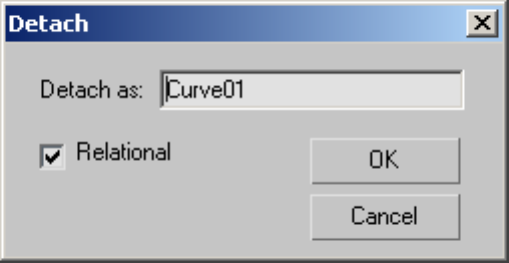
Yes Closes the curve and ends curve creation.
No Keeps the curve open and does not end curve creation.
Detach Dialog (NURBS)
Modify panel > Select a NURBS sub-object. > Curve Common or Surface
Common rollout > (optional) Copy toggle > Detach button
This dialog appears when you use Detach to create a new top-level NURBS
curve or surface sub-object.
Interface
Detach as Lets you assign a name to the new object. By default, the name
is "Curve" or "Surface" followed by a sequence number.
This option is unavailable when Detach To Element is on.
Relational This toggle affects dependent objects. When off, detaching a
dependent sub-object makes it an independent object. For example, detaching
a U loft converts it to a CV surface. When on, detaching a dependent sub-object
also detaches the objects on which it depends, so the object remains
dependent. For example, detaching a U loft also detaches the curves that
define it. Default=on.
Creating and Editing NURBS Sub-Objects | 2449
Edit Curve on Surface Dialog
Select NURBS object. > Modify panel > Stack display > Curve sub-object level
> Select NURBS curve on surface sub-object. > CV Curve on Surface or Point
Curve on Surface rollout > Edit button
This dialog lets you edit curves on surfaces as you edit regular curves in a
viewport. The main part of the dialog is a two-dimensional view of the surface.
The controls provide typical curve editing functions.
This is a modeless dialog. You can use the main 3ds Max window while Edit
Curve on Surface remains open. However, if you select a different kind of
curve or a sub-object that isn't a curve, the dialog closes.
You can edit multiple CV on surface on page 2327 or Point on surface on page
2331 curves, but you can't edit both types of curves at the same time.
The point whose surface you first click is shown as a blue square in the dialog
as well as in viewports. As you draw the curve, it appears interactively in
viewports and a blue asterisk (*) shows the current mouse location on the
surface.
While you are creating a curve, you can press Backspace to remove the last
point or CV you created, and then previous points or CVs in reverse order.
2450 | Chapter 10 Surface Modeling
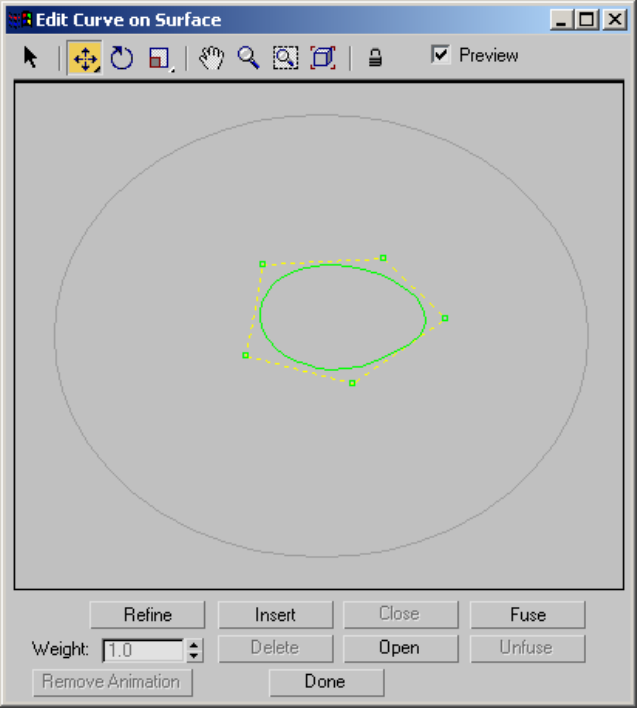
Interface
Toolbar
The toolbar above the surface image provides selection, transform and viewing
controls. These controls work the way their analogs do in the main 3ds Max
viewports. The toolbar is disabled while you create a new curve on surface.
Select Selects one or more points. Drag a window to select multiple points.
Move Moves the selected points.
Creating and Editing NURBS Sub-Objects | 2451
Move is a flyout. The alternative buttons constrain texture points to move
either vertically or horizontally.
Rotate Rotates the selected points.
Scale Scales the selected points. This is a flyout that lets you choose between
uniform scale, nonuniform scale in the surface's U dimension, or nonuniform
scale in the surface's V dimension.
Pan Pans the surface view.
Zoom Zooms in or out on the surface view.
Zoom Window Zooms to a window you drag on the surface view.
Zoom Extents Zooms to the extents of the surface.
Lock Selection Locks the active selection set. You can turn this on to keep
from accidentally selecting other points or CVs while you're transforming a
selection set.
Preview When on (the default), edits you make in the dialog are also shown
in viewports.
Curve on Surface Image
Below the toolbar is a 2D image of the curve. This image shows the points or
CVs of the curve, allowing you to edit it as you edit sub-objects in viewports.
If you right-click while in the image, a pop-up menu lets you switch between
Select, Move, Rotate, and Scale. This is an alternative to using the toolbar.
If your mouse has a middle button, you can use it to pan in this window.
Buttons and Weight
These controls are comparable to editing controls on the rollouts for point
sub-objects. (The Open button works differently.) These controls are disabled
while you create a new curve on surface.
Refine Adds points to the curve. This does not change curvature. For point
curves, the curvature can change, but only slightly.
Insert (Not available for point curves on surfaces.)
Close Closes the curve.
Fuse Fuses two points.
Weight (Not available for point curves on surfaces.)
2452 | Chapter 10 Surface Modeling

Delete Deletes the selected points.
Open Opens the curve by unfusing the points where the curve was originally
closed.
Unfuse Unfuses the selected points.
Remove Animation Removes animation controllers from the selected points
or CVs.
Edit Texture Surface Dialog
Modify panel > Select NURBS surface sub-object. > Material Properties rollout
> Texture Channels group box > Turn on Gen. Mapping Coords. > Texture
Surface group box > Choose User-Defined. > Edit Texture Surface button
This dialog lets you edit the texture surface for a surface sub-object. It is
available when you have chosen User Defined as the sub-object's texture
surface method.
A texture surface is associated with the surface sub-object. The texture surface
is used to control how materials are mapped. In effect, changing the texture
surface stretches or otherwise changes the UV coordinates for the surface,
altering the mapping.
The Edit Texture Surface dialog shows a 2D view of the texture surface. You
can also edit user-defined texture surfaces directly in 3D viewports, using the
Edit Texture Points button. See Material Properties Rollout on page 2278 .
Maps can shift with certain surface approximation methods. This effect is
especially noticeable when the surface has animated CVs. You can reduce or
eliminate map shifting by changing the mapping method to User Defined.
TIP Don't use the UVW Map modifier to apply a texture to an animated NURBS
surface.
Creating and Editing NURBS Sub-Objects | 2453
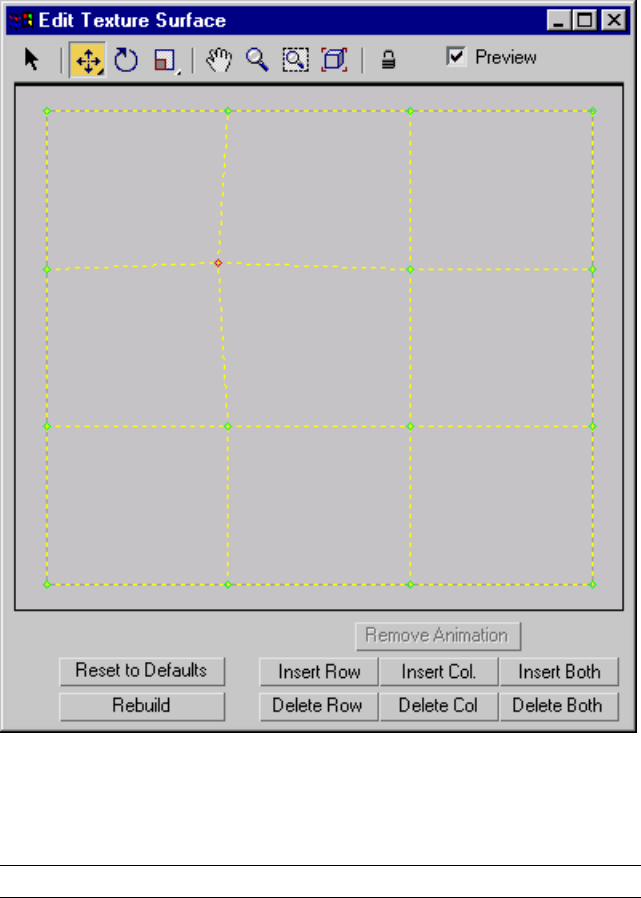
Interface
Toolbar
The toolbar above the surface image provides selection, transform and viewing
controls. These controls work the way their analogs do in viewports.
NOTE You can animate transforms to the texture surface points.
Select Selects one or more points. Drag a window to select multiple points
or CVs.
2454 | Chapter 10 Surface Modeling
Move Moves the selected points.
Move is a flyout. The alternative buttons constrain texture points to move
either vertically or horizontally.
Rotate Rotates the selected points.
Scale Scales the selected points. This is a flyout that lets you choose between
uniform scale, nonuniform scale in the surface's U dimension, or nonuniform
scale in the surface's V dimension.
Pan Pans the surface view.
Zoom Zooms in or out on the surface view.
Zoom Window Zooms to a window you drag on the surface view.
Zoom Extents Zooms to the extents of the surface.
Lock Selection Locks the active selection set. You can turn this on so you
don't accidentally select other points while you're transforming a selection
set.
Preview When on (the default), your edits are also shown in viewports. In
viewports, selected texture points are displayed in red, and the others are
displayed in green.
Texture Surface Image
Below the toolbar is a 2D image showing the points of the texture surface.
You can edit the texture surface as you edit sub-objects in viewports.
If you right-click while in the image, the popup menu lets you switch between
Select, Move, Rotate, and Scale. This is an alternative to using the toolbar.
If your mouse has a middle button, you can use it to pan in this window.
Texture Surface Controls
The controls below the surface image edit the texture surface.
Remove Animation Removes animation controllers from the selected texture
points.
Reset to Defaults Resets user-defined mapping to the default.
Rebuild Displays the Rebuild Texture Surface dialog on page 2465 , which
rebuilds the texture surface and lets you change the number of CV rows or
columns.
Creating and Editing NURBS Sub-Objects | 2455
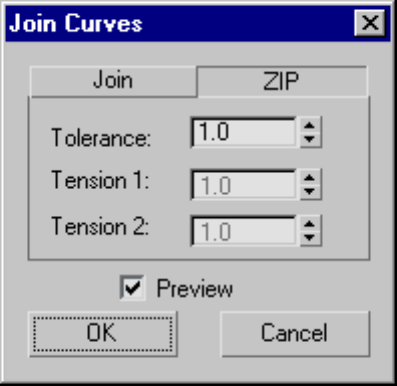
Insert Row, Insert Col., Insert Both Click one of these buttons to insert a
row or column of points, or both at once, into the surface. Insertion adds
points without moving other rows and columns.
While you refine the surface, the operation is previewed the same way Insert
is previewed in 3D viewports.
Delete Row, Delete Col., Delete Both Click one of these buttons to delete a
row or column of points, or both at once.
Join Curves Dialog
Modify panel > Select NURBS curve sub-object. > Curve Common rollout >
Join button > Join two curves in a viewport.
This dialog lets you choose the way to join two curves.
Interface
ZIP tab
This tab chooses the zip algorithm. Zipping concatenates the CV lattices of
the two original curves. Zipping can change the shape of the original curves,
but usually it produces a better result than joining.
By default, the ZIP tab is active.
2456 | Chapter 10 Surface Modeling
If both curves are untrimmed point curves, the result of zipping is a point
curve. In all other cases, the result is a CV curve.
Tolerance A distance in 3ds Max units. If the ends of the two original curves
are closer than this distance, zipping deletes one of the points or CVs in order
to avoid creating coincident points or CVs in the new zipped curve.
Tension 1 (Disabled.)
Tension 2 (Disabled.)
Join tab
This tab chooses the join algorithm. Joining first creates a blend curve between
the two original curves, and then makes all three into a single curve. Joining
does not change the shape of the two original curves.
If both curves are point curves, the result is a point curve. If one or both curves
are CV curves, the result is a CV curve.
Tolerance A distance in 3ds Max units. If the gap between the curves you
are joining is greater than this value, the join is created by first creating a
blend curve and then joining the three parts. If the gap is less than this value,
or if the curves are overlapping or coincident, the software doesn't create the
blend.
Creating a blend and then joining the three curves into a single curve is the
better technique. The result matches the parent curves well. Without the blend
step, the resulting curve can deviate from the parent curves, in order to
maintain smoothness. (The amount of deviation depends on how far from
tangent the two input curves were at the join.)
A problem arises when the gap is too small. In this case, the software generates
the blend but because there isn't enough room for it, the resulting curve has
a loop. To avoid having this loop, set the Tolerance higher than the gap
distance.
If you set the tolerance to 0.0, the software chooses a value to use for the
Tolerance.
Tension 1 Adjusts the tension of the new curve at the end of the first curve
you picked.
Tension 2 Adjusts the tension of the new curve at the end of the second
curve you picked.
Preview When on, the effect of the zip or join is previewed in viewports.
Default=on.
Creating and Editing NURBS Sub-Objects | 2457
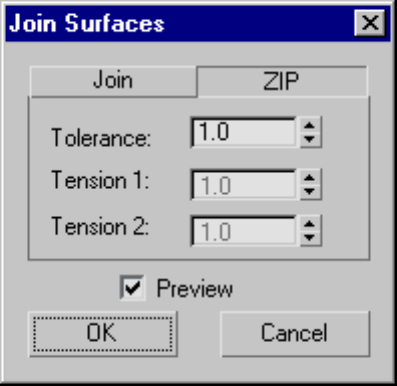
Join Surfaces Dialog
Modify panel > Select NURBS surface sub-object. > Surface Common rollout
> Join button > Join two surfaces in a viewport.
This dialog lets you choose the way to join two surfaces.
Interface
ZIP tab
This tab chooses the zip algorithm. Zipping concatenates the CV lattices of
the two original surfaces. Zipping can change the shape of the original surfaces,
but compared to joining it usually produces a simpler surface that is easier to
edit.
By default, the ZIP tab is active.
If both curves are untrimmed point surfaces, the result of zipping is a point
surface. In all other cases, the result is a CV surface.
Tolerance A distance in 3ds Max units. If the edges of the two original
surfaces are closer than this distance, zipping deletes one row (or column) of
the points or CVs in order to avoid creating a coincident point or CV row (or
column) in the new zipped surface.
Tension 1 (Disabled.)
2458 | Chapter 10 Surface Modeling
Tension 2 (Disabled.)
Join tab
This tab chooses the join algorithm. (This method was the only way to join
surfaces in 3ds Max prior to v3.) Joining first creates a blend surface between
the two original surfaces, and then makes all three into a single surface. Joining
does not change the shape of the two original surfaces.
If both surfaces are point surfaces, the result is a point surface. If one or both
surfaces are CV surfaces, the result is a CV surface.
Tolerance A distance in 3ds Max units. If the gap between the surfaces you
are joining is greater than this value, the join is created by first creating a
blend surface and then joining the three parts. If the gap is less than this value,
or if the surfaces are overlapping or coincident, the software doesn't create
the blend.
Creating a blend and then joining the three surfaces into a single surface is
the better technique. The result matches the parent surfaces well. Without
the blend step, the resulting surface can deviate from the parent surfaces, in
order to maintain smoothness. (The amount of deviation depends on how
far from tangent the two input surfaces were at the join.)
A problem arises when the gap is too small. In this case, the software generates
the blend but because there isn't enough room for it, the resulting surface has
a loop. To avoid having this loop, set the Tolerance higher than the gap
distance.
If you set the tolerance to 0.0, the software chooses a value to use for the
Tolerance.
Tension 1 Adjusts the tension of the new surface at the edge of the first
surface you picked.
Tension 2 Adjusts the tension of the new surface at the end of the second
surface you picked.
Preview When on, the effect of the zip or join is previewed in viewports.
Default=on.
Make Loft Dialog
Modify panel > Select NURBS surface sub-object. > Surface Common rollout
> Make Loft button
Creating and Editing NURBS Sub-Objects | 2459
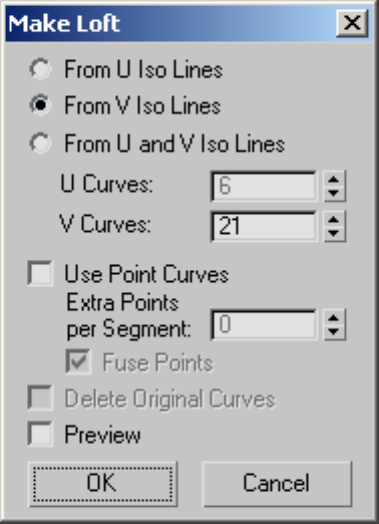
This dialog converts a surface sub-object to a (dependent) U loft or UV loft
surface. You can also change the dimension used to construct a U loft surface.
Interface
From U Iso Lines Uses curves along the surface's U dimension to construct
a U loft.
From V Iso Lines Uses curves along the surface's V dimension to construct
a U loft. If the surface was already a U loft, set this to change the lofting
dimension.
From U and V Iso Lines Uses curves from both the U and V dimensions to
construct a UV loft.
U Curves Sets the number of curves in U.
V Curves Sets the number of curves in V.
Use Point Curves When on, constructs the loft from point curves instead of
the default CV curves. Default=off.
2460 | Chapter 10 Surface Modeling
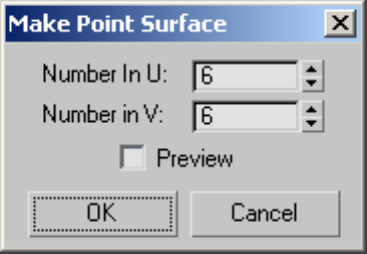
Extra Points per Segment This control is enabled only for UV lofts (From U
and V Iso Lines). Lets you increase the number of points in each segment.
Fuse Points This control is enabled only for UV lofts (From U and V Iso
Lines). When on, fuses points at curve intersections to ensure that the U and
V curves continue to intersect when you edit the surface, and that the surface
remains coincident with its parent curves. UV lofts constructed from
intersecting curves behave more predictably. Default=on.
Delete Original Loft Curves This is available only if the surface was already
a U loft or UV loft. When on, Make Loft deletes the original loft curves when
you click OK. When off, the original curves remain where they are. Default=off.
Preview When on, displays a preview of the new loft surface. Loft creation
is faster when Preview is off. Default=off.
Make Point Dialog
Modify panel > Select NURBS surface sub-object. > Surface Common rollout
> Make Point button
This dialog converts a CV surface sub-object to a point surface sub-object.
Interface
Number in U Sets the number of columns.
Number in V Sets the number of rows.
Preview When on, your changes are previewed in viewports. Point surface
conversion is faster when Preview is off. Default=off.
Creating and Editing NURBS Sub-Objects | 2461
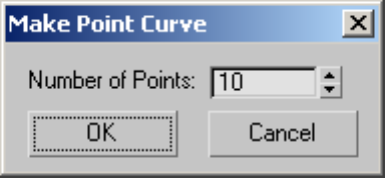
Make Point Curve Dialog
Modify panel > Select NURBS curve sub-object. > Curve Common rollout >
Make Fit button
The Make Fit button for a NURBS curve sub-object turns a CV curve into a
point curve. For point curves, it lets you change the number of points. It
displays this dialog.
Interface
Number of Points Sets the number of points in the point curve.
Point Curve: Close Curve Dialog
Create panel > Shapes button > Point Curve button > In viewports, draw a
point curve and click to create a point in the same location as the first point
in the curve.
Modify panel > Select NURBS object. > NURBS toolbox > Create Point Curve
> In viewports, draw a point curve sub-object and click to create a point in
the same location as the first point in the curve.
This dialog lets you create a closed point curve when you click to create a
point in the same location as the curve's first point.
2462 | Chapter 10 Surface Modeling
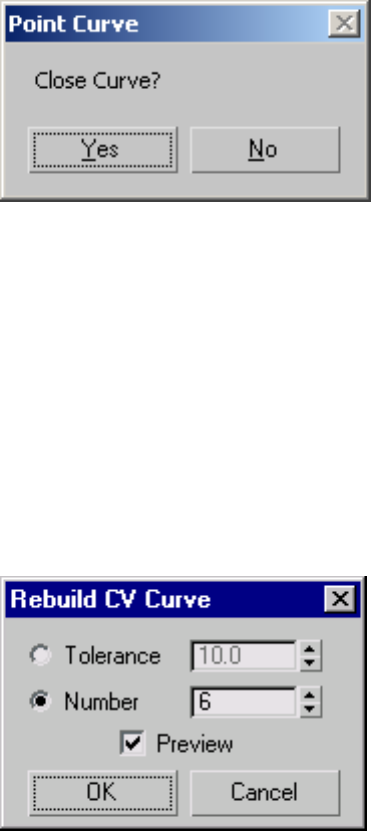
Interface
Yes Closes the curve and ends curve creation.
No Keeps the curve open and does not end curve creation.
Rebuild CV Curve Dialog
Modify panel > Select NURBS object. > Stack display > Curve sub-object level
> Select an independent CV curve sub-object. > CV Curve rollout > Rebuild
button
The Rebuild button for CV curves displays this dialog. It lets you specify how
to rebuild the curve. Rebuilding the curve can change its appearance.
Interface
Tolerance Rebuilds the curve according to accuracy. The lower the Tolerance
value, the more accurate the rebuild. Increasing Tolerance enables the curve
to be rebuilt using fewer CVs.
Number (The default.) Lets you alter the number of CVs in the curve.
Creating and Editing NURBS Sub-Objects | 2463
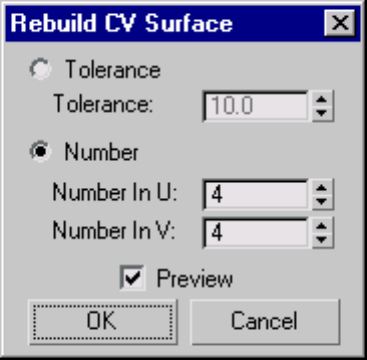
Preview When on (the default), your changes are previewed in viewports.
Rebuild CV Surface Dialog
Modify panel > Select NURBS object. > Stack display > Surface sub-object level
> Select an independent CV surface sub-object. > CV Surface rollout > Rebuild
button
The Rebuild button for CV surfaces displays this dialog. It lets you specify how
to rebuild the surface. Rebuilding the surface can change its appearance.
Interface
Tolerance Rebuilds the surface according to accuracy. The lower the Tolerance
value, the more accurate the rebuild. Increasing Tolerance enables the surface
to be rebuilt using fewer CVs.
Number (The default.) Lets you alter the number of CVs in the surface.
Number in U specifies the number in the U dimension, and Number in V
specifies the number in the V dimension. These values default to the numbers
that already exist in the surface.
Preview When on (the default), your changes are previewed in viewports.
2464 | Chapter 10 Surface Modeling
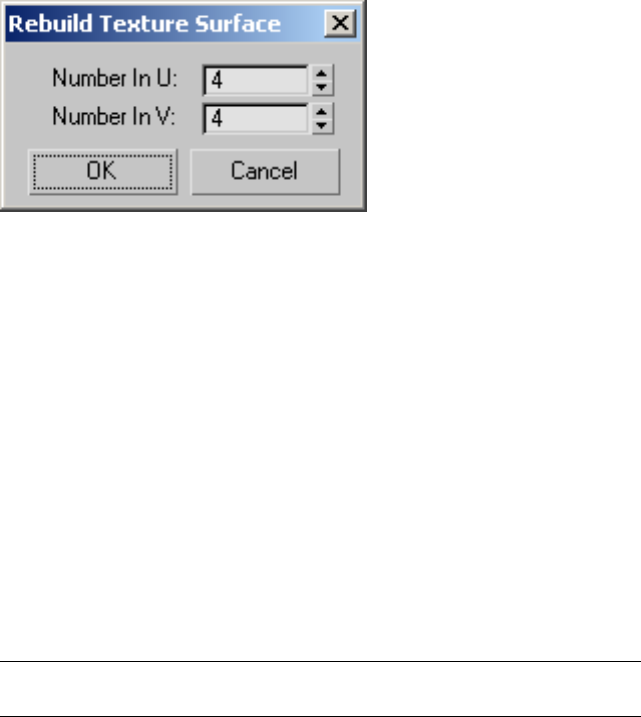
Rebuild Texture Surface Dialog
Modify panel > Select NURBS surface sub-object. > Surface sub-object level >
Material Properties rollout > Texture Channels group box > Turn on Gen.
Mapping Coords. > Texture Surface group box > Choose User-Defined. > Edit
Texture Surface button > Edit Texture Surface dialog > Rebuild button
This dialog rebuilds the texture surface and lets you change the number of
CV rows or columns.
Interface
Number in U Sets the number of CV columns.
Number in V Sets the number of CV rows.
Reparameterize Dialog
Modify panel > Select NURBS object. > Stack display > Curve sub-object level
> Select an independent CV curve sub-object. > CV Curve rollout > Reparam.
button
Modify panel > Select NURBS object. > Stack display > Curve sub-object level
> Select an independent CV surface sub-object. > CV Surface rollout > Reparam.
button
The Reparam. button for CV curves and surfaces displays this dialog.
Reparameterizing a CV sub-object changes its parameter space on page 7882
to provide a better relation between control point locations and the shape of
the sub-object.
TIP It is a good idea to reparameterize after you have added CVs to a curve or
surface by refining or inserting.
Creating and Editing NURBS Sub-Objects | 2465
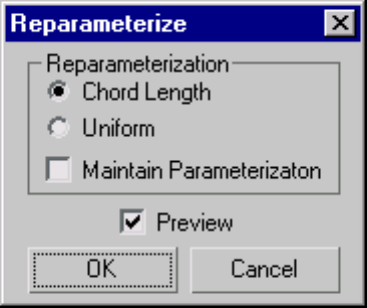
Interface
Chord Length Chooses the chord-length algorithm for reparameterization.
Chord-length reparameterization spaces knots (in parameter space on page
7882 ) based on the square root of the length of each curve segment.
Chord-length reparameterization is usually the best choice.
Uniform Spaces the knots uniformly.
A uniform knot vector has the advantage that the curve or surface changes
only locally when you edit it. With chord-length parameterization, moving
any CV can potentially change the entire sub-object.
Maintain Parameterization When on, the curve is automatically
reparameterized as you edit it, using the currently active method of
reparameterization. When off, no reparameterization happens unless you use
this dialog. Default=off.
Preview If on (the default), displays the effects of reparameterizing in
viewports.
Sub-Object Clone Options Dialog
Modify panel > Select NURBS surface or curve sub-object. > Shift+Clone. >
Clone Options dialog
When you Shift+Clone on page 968 a surface or curve sub-object, the Clone
Options dialog appears. This dialog asks whether you want the clone to be a
relational copy, an independent copy, or a transform.
2466 | Chapter 10 Surface Modeling
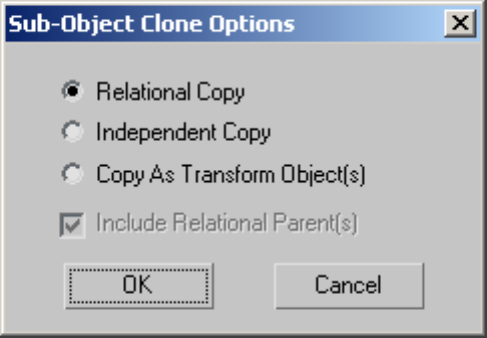
Interface
Relational Copy The cloned object is the same type as the original. If the
original object was a dependent object, the clone includes copies of the parents.
For example, when you clone a Blend surface, the clone remains a Blend
surface and its two parent surfaces are copied along with it.
Because all related sub-objects are copied, Relational Copy can be
time-consuming.
Independent Copy The cloned object is an independent CV curve or CV
surface. It has the same shape as the original, but its relational dependencies
aren't copied. This method of cloning uses less time and memory, although
you lose the relational properties. For example, when you clone a Blend surface,
the clone is an independent CV surface.
Copy as Transform Object(s) The "clone" is actually a transform curve or
transform surface, based on the original object and still dependent on it. This
lets you create transform curves and surfaces based on a rotation and scale as
well as on translation.
Include Parent(s) (Available only for Independent Copy or Copy as Transform
Object(s).) Tells the system whether or not to include the parents of the
dependent object. For example, if Include Parent(s) is on when you clone a
blend surface, the two parent surfaces are also cloned as independent CV
surfaces. If Include Parent(s) is off, only the one curve or surface is cloned.
Cloning is slower when Include Parent(s) is on, although quicker than
Relational Copy.
Creating and Editing NURBS Sub-Objects | 2467

Select By Material ID Dialog
Modify panel > Select NURBS object. > Stack display > Curve sub-object level
> Select By ID button.
This dialog lets you select curve sub-objects by the material ID number assigned
to them.
Interface
ID Specifies the material ID you want to select.
Clear Selection When on, replaces the current selection (if any) by the
material ID selection. When off, adds the material ID selection to the current
selection set.
Curve and Surface Approximation
Curve Approximation
Modify panel > Select top-level NURBS object. > Curve Approximation rollout
Although NURBS curves are analytically generated, in order to generate and
display them they must be approximated by line segments.
Curve approximation controls are displayed in the creation parameters for
curve objects, and on a Curve Approximation rollout for NURBS models
(top-level NURBS objects). At the model level, approximation controls affect
all curve sub-objects in the model.
Curve approximation is accomplished by segments. One or more line segments,
or steps, are used to approximate each segment of the curve. For point curves,
a segment of a curve is the portion between one point and the next. For CV
2468 | Chapter 10 Surface Modeling
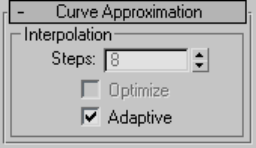
curves, the segment is determined by the CV’s parametric knot on page 7825 .
The transition from one CV curve segment to another isn’t visible in viewports.
Curve approximation parameters aren't animatable.
Interface
Steps The maximum number of line segments used to approximate each
curve segment. If the curve displays or renders with angles, increase this value.
This control is unavailable when Adaptive is on. Range=1 to 100.
Optimize Turn on this check box to optimize the curve. When on,
interpolation uses the specified Steps value unless two segments are collinear,
in which case they are converted to a single segment. This control is
unavailable when Adaptive is on.
Adaptive (The default.) Segments the curve adaptively, based on its curvature.
In other words, the curve is assigned more segments where its curvature is
greatest, and fewer segments where its curvature is less.
Surface Approximation
Modify panel > Select top-level NURBS object. > Surface Approximation rollout
Modify panel > Select NURBS surface sub-object. > Surface Approximation
rollout
Although NURBS surfaces are analytically generated, in order to generate and
display them they must be approximated by faces. You use the controls
described in this section to set the type of approximation used and its
parameters.
The Surface Approximation rollout controls how surface sub-objects in the
NURBS model are approximated for purposes of rendering and viewport
display. NURBS can be approximated differently in viewports and in the
renderer. Typically you want viewport display to be clear and quick, while
you want rendered display to be smooth, accurate, and "realistic." However,
the approximation you choose for viewports creates a mesh, and the kind of
Curve and Surface Approximation | 2469

mesh you choose can affect the behavior of modifiers that you later apply to
the NURBS model.
The first two controls on this rollout are radio buttons for selecting the kind
of display output, viewport or renderer, these parameters control.
Surface approximation parameters are not animatable.
NOTE If the size or shape of a surface changes over time, the tessellation used to
approximate it can change (automatically) as well. This has the advantage of
improving render time in animations. It has the disadvantage that you can't apply
image motion blur on page 7814 to NURBS objects whose tessellation changes
during animation. The Regular method of tessellation is the exception: it doesn't
change when animated, so you can use image motion blur with Regular tessellation.
Surface Approximation Per Surface
By default, surface sub-objects use the same approximation settings as the
top-level NURBS model. You can override these settings. Each surface sub-object
now has a Surface Approximation rollout of its own. The controls on this
rollout are disabled unless you turn off the Lock to Top Level toggle. With
this toggle turned off, you can choose approximation settings specific to this
surface sub-object.
2470 | Chapter 10 Surface Modeling
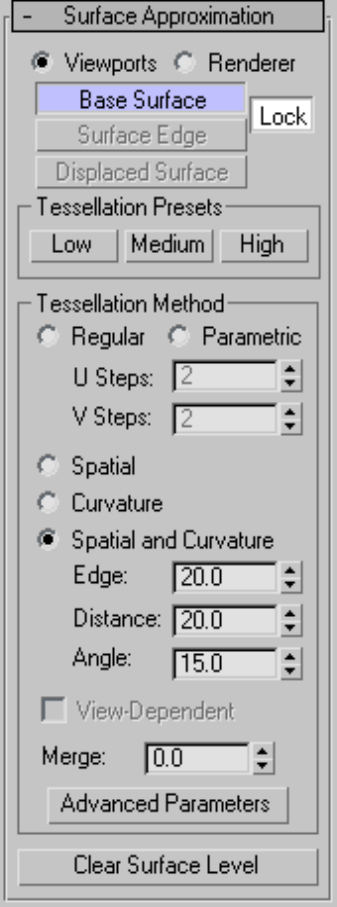
Interface
Curve and Surface Approximation | 2471
Tessellation group
Viewports When chosen, the rollout affects how surfaces in the NURBS
object are displayed interactively in viewports, including shaded viewports,
and by the preview renderer.
The Viewports surface settings are also used when you apply a mesh modifier
such as Mesh Select to the NURBS object. This is important because the
modifier can affect the scene's geometry.
Renderer When chosen, the rollout affects how surfaces in the NURBS object
are displayed by the renderer, and by the draft renderer for Quick Render.
The next cluster of buttons lets you choose which portions of the geometry
are affected by the surface approximation settings.
Base Surface Settings affect the entire surface. This is the default.
Surface Edge Turn on to set approximation values for tessellating surface
edges that are defined by trim curves. With Lock turned off, the surface and
edge tessellation values are independent of each other.
For object-level surfaces, this is unavailable unless Lock (described below) is
turned off.
Displaced Surface Turn on to set a third, independent approximation setting
for surfaces that have a displacement map on page 5391 applied to them.
Available only when Renderer is chosen.
Using a preset approximation setting (in the Presets group box) should give
you faster results for displaced surfaces.
Lock (for object-level surfaces only) Locks the Base Surface settings to the
Surface Edge settings. In other words, surfaces and surface edges have a
relational tessellation setting unless Lock is turned off. Default=on.
Tessellation Presets group
Lets you choose a preset low, medium, or high quality surface approximation.
While a preset is chosen, the values it uses are displayed on the Tessellation
Method rollout.
Preset values are saved in the 3dsmax.ini on page 51 file. You can customize
the preset values by using the Surface Approximation utility on page 2480 .
Low Selects a (comparatively) low-quality surface approximation. These are
the default values:
Viewports, Base Surface:
2472 | Chapter 10 Surface Modeling
Method=Spatial and Curvature Edge=50.0 Distance=50.0 Angle=50.0 Merge=0.0
Advanced Parameters > Minimum=0, Maximum=3
Renderer, Base Surface:
Method=Spatial and Curvature Edge=20.0 Distance=20.0 Angle=15.0
Merge=0.01 Advanced Parameters > Minimum=0, Maximum=3
Renderer, Displaced Surface:
Method=Spatial and Curvature Edge=20.0 Distance=20.0 Angle=10.0
Merge=(Unavailable) Advanced Parameters > Minimum=0, Maximum=2
Keyboard shortcut: Alt+1
Medium (The default for both viewports and rendering.) Selects a
medium-quality surface approximation. These are the default values:
Viewports, Base Surface:
Method=Spatial and Curvature Edge=20.0 Distance=20.0 Angle=15.0 Merge=0.0
Advanced Parameters > Minimum=0, Maximum=3
Renderer, Base Surface:
Method=Spatial and Curvature Edge=10.0 Distance=15.0 Angle=10.0
Merge=0.01 Advanced Parameters > Minimum=0, Maximum=4
Renderer, Displaced Surface:
Method=Spatial and Curvature Edge=10.0 Distance=10.0 Angle=4.0
Merge=(Unavailable) Advanced Parameters > Minimum=0, Maximum=3
Keyboard shortcut: Alt+2
High Selects a high-quality surface approximation. These are the default
values:
Viewports, Base Surface:
Method=Spatial and Curvature Edge=5.0 Distance=15.0 Angle=10.0 Merge=0.0
Advanced Parameters > Minimum=0, Maximum=3
Renderer, Base Surface:
Method=Spatial and Curvature Edge=5.0 Distance=5.0 Angle=3.0 Merge=0.01
Advanced Parameters > Minimum=0, Maximum=4
Renderer, Displaced Surface:
Method=Spatial and Curvature Edge=5.0 Distance=5.0 Angle=2.0
Merge=(Unavailable) Advanced Parameters > Minimum=0, Maximum=4
Curve and Surface Approximation | 2473

Keyboard shortcut: Alt+3
NOTE The keyboard shortcuts for surface approximation presets don't require
that the Keyboard Shortcut Override Toggle be on. You can change the surface
approximation of NURBS objects by selecting them in a viewport, and then using
Alt+1, Alt+2, or Alt+3. This works for sub-objects as well, but the surface sub-object's
Lock to Top Level toggle must be turned off.
Tessellation Method group
The controls in this group affect the display of the NURBS surface in viewports
if you have chosen Viewports above, or by the renderer if you have chosen
Renderer above. You can choose between five algorithms. Each approximates
NURBS surfaces by tessellating them in a different way.
Generally speaking, if the preset values you have chosen give good results,
you don't need to adjust the controls on this rollout. Adjust them if you
encounter problems with the preset alternative.
Tips
■Viewport Tessellation: The tessellation method creates the mesh. If you
modify the NURBS object with Mesh Select on page 1455 , choose the method
that gives the result you need. If you use modifiers heavily, Spatial or
Parametric might be better than Curvature, because of their regular
tessellation. Curvature-dependent tessellation can cause problems with
some modifiers.
■Renderer Tessellation: Spatial and Curvature usually obtains the most
accurate rendering. Curvature can be the more efficient choice when you
render animated surfaces.
Lock to Top Level (for sub-object surfaces only) When on, the surface
sub-object uses the same surface approximation settings as the top-level NURBS
model, and other controls on this rollout are disabled. When turned off, you
can set the sub-object approximation to differ from the top-level model.
Default=on.
Regular Generates a fixed tessellation across the surface based on U Steps
by V Steps. Increasing these parameters increases accuracy at a cost of speed,
and vice versa, but in general this can be the quickest and least accurate way
to approximate a NURBS surface. Very low values for U and V Steps using the
Regular method usually doesn't provide good results. Model complexity
increases slowly as U and V Steps values increase.
2474 | Chapter 10 Surface Modeling
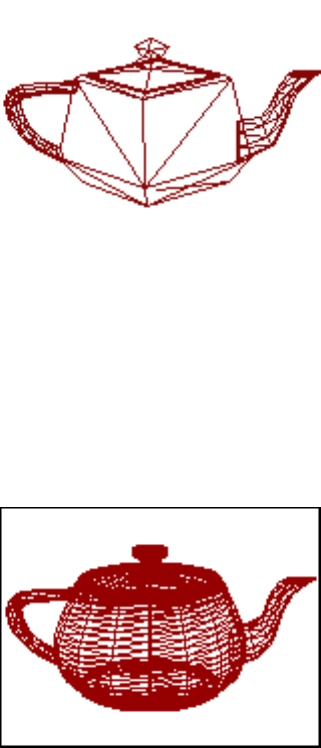
Regular mesh of the NURBS teapot
Parametric Generates an adaptive tessellation based on U Steps by V Steps.
Low values for U and V Steps using the Parametric method often provide good
results. Model complexity increases rapidly as U and V Steps values increase,
so take care when you switch from Regular, which generally requires higher
U and V values, to Parametric, where lower U and V values generally suffice.
For example, if you convert a teapot to NURBS and set the U and V steps to
15, the Regular method generates 4470 faces but the Parametric method
generates 204960 faces.
Parametric mesh of the NURBS teapot
Spatial Generates a uniform tessellation made of triangular faces.
The Edge parameter specifies the maximum length of a triangular face in the
tessellation. The value is a percentage of the object's bounding box. Decreasing
this value increases accuracy but increases rendering time.
Curve and Surface Approximation | 2475

Spatial mesh of the NURBS teapot
Curvature (The default.) Generates a variable tessellation based on the
curvature of the surface. The tessellation has a finer grain where the surface
is more curved. Changing surface curvature dynamically changes the curvature
tessellation.
The Distance parameter specifies how far the approximation can deviate from
the actual NURBS surface. Distance is a percentage of the diagonal of each
surface's bounding box. Each surface in an object is tessellated based on its
size, independently of other surfaces. Scaling a surface doesn't change its
tessellation. Decreasing this value increases accuracy but increases rendering
time. When you set Distance to 0.0, the software ignores this parameter and
uses the Angle to control accuracy.
The Angle parameter specifies the maximum angle between faces in the
approximation. Decreasing this value increases accuracy but increases rendering
time. When you set Angle to 0.0, the software ignores this parameter and uses
Distance to control accuracy.
When both Distance and Angle are 0.0, the surfaces degenerate and can become
flat surfaces.
Curvature mesh of the NURBS teapot
2476 | Chapter 10 Surface Modeling
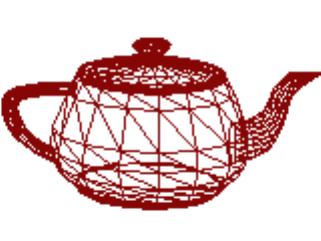
Spatial and Curvature Combines the spatial (edge-length) method and the
curvature (distance and angle) methods, using all three values.
The Edge parameter specifies the maximum length of a triangular face in the
tessellation. The value is a percentage of the object's bounding box. Decreasing
this value increases accuracy but increases rendering time. When you set Edge
to 0.0, the effect is equivalent to the Curvature method.
The Distance parameter specifies how far the approximation can deviate from
the actual NURBS surface. Distance is a percentage of the diagonal of each
surface’s bounding box. Each surface in an object is tessellated based on its
size, independently of other surfaces. Scaling a surface doesn’t change its
tessellation. Decreasing this value increases accuracy but increases rendering
time. When you set Distance to 0.0, the software ignores this parameter and
uses the Edge and Angle values to control accuracy.
The Angle parameter specifies the maximum angle between faces in the
approximation. Decreasing this value increases accuracy but increases rendering
time. When you set Angle to 0.0, the software ignores this parameter and uses
the Edge and Distance values to control accuracy.
When Distance, Angle, and Edge are all 0.0, the surfaces degenerate and can
become flat surfaces.
Spatial and Curvature mesh of the NURBS teapot
View-Dependent (for the Renderer only) When on, takes the object's distance
from the camera into account while calculating tessellation. This can improve
rendering time by not generating fine-grained tessellations for objects in the
distance of the rendered scene. The view-dependent effect works only when
you render camera or perspective views. It doesn't work in orthographic views.
This control is disabled while Viewports is active.
Curve and Surface Approximation | 2477

For the Spatial, Curvature, and Spatial and Curvature methods, the Distance
and Edge values specify pixels instead of 3ds Max units when View-Dependent
is on.
NOTE When View-Dependent is on, tessellation quickly reaches the maximum
subdivision limit. You might want to increase this value to 7 (the greatest value
allowed). See the description of Advanced Parameters, below.
Merge (sub-object surfaces only) Controls the tessellation of surface
sub-objects whose edges are joined or very nearly joined. When input to a
modifier (such as Mesh Select) requires a mesh, and when NURBS surfaces are
tessellated for production rendering, by default the software adjusts the
tessellation of adjoining surfaces to match each other, in terms of the number
of faces along the edges. The Merge parameter controls how this is done. If
Merge is zero, adjoining faces are unchanged. Increasing the value of Merge
increases the distance the software uses to calculate how edges should match,
guaranteeing no gaps between the surfaces when they are rendered.
Default=0.0.
In most cases, you don't need to adjust Merge. If rendering shows gaps between
nearly adjoining faces, increase Merge to eliminate them.
Technically, the Merge value is 0.1 percent of the diagonal of the object's
bounding box. In other words, a Merge value of 1.0 (higher than necessary
for most purposes) is 0.1 percent of the length of the diagonal. Because Merge
is based on the object's dimensions, you can scale the NURBS model without
affecting the Merge setting.
Advanced Parameters Click to display the Advanced Surface Approximation
dialog on page 2478 . The parameters in this dialog apply to the Spatial,
Curvature, and Spatial and Curvature approximation methods.
Clear Surface Level (Appears only for top-level surfaces.) Clears all surface
approximation settings assigned to individual surface sub-objects. When you
click this button, all surface-specific approximations are lost, and Lock to Top
Level is on for surface sub-objects.
Advanced Surface Approximation Dialog
Modify panel > Select a NURBS surface object or surface sub-object. > Surface
Approximation rollout > Tessellation Method group box > Turn off Lock to
Top Level > Advanced Parameters button
2478 | Chapter 10 Surface Modeling
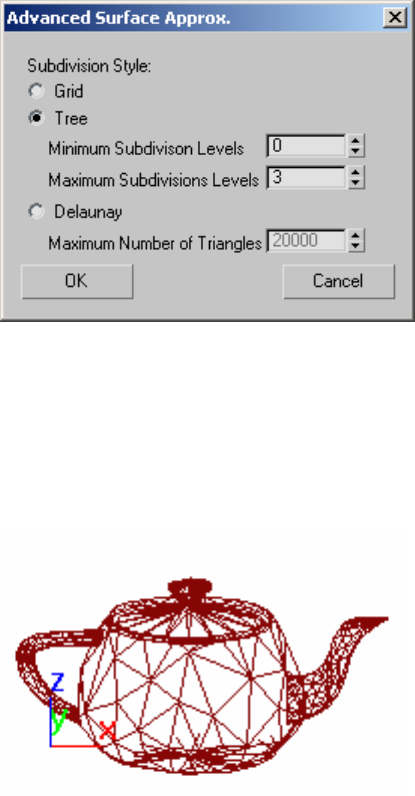
Select an editable mesh object. > Modify panel > Surface Properties rollout >
Advanced Parameters button
This dialog sets parameters that control the tessellation used in the Spatial,
Curvature, and Spatial and Curvature approximation methods.
Interface
Subdivision Style
Chooses the method used to subdivide the surface:
Grid Subdivides the surface using a regular grid.
Tree (The default.) Subdivides the surface using a binary tree.
Delaunay Subdivides the surface using nearly equilateral triangles.
Delauney surface subdivision style
Curve and Surface Approximation | 2479
Subdivision Limits
For Grid or Tree subdivisions, the limits control the number of recursive
decompositions that are performed during tessellation.
Minimum Subdivision Levels Sets the minimum number of recursions.
Default=0.
Maximum Subdivision Levels Sets the maximum number of recursions. The
maximum can be no greater than 7. Be careful: setting the maximum greater
than 5 can result in massive face counts and poor performance. Default=3.
Maximum Number of Triangles
For Delaunay subdivision, the Maximum Number of Triangles lets you specify
the maximum number of triangles into which the surface will be divided.
Default=20000.
Surface Approximation Utility
Utilities panel > Utilities rollout > More button > Utilities dialog > Surface
Approximation
The Surface Approximation utility lets you change approximation and display
settings without going into the NURBS model, and is especially useful for
changing settings on multiple NURBS objects at once.
It has two rollouts, one for surface approximation and the other for surface
display controls.
Surface Approximation Rollout on page 2481
Surface Display Rollout on page 2491
Procedures
To use the Surface Approximation utility:
1On the Utilities panel, click the More button, and choose Surface
Approximation from the list.
2Set the desired options on the Surface Approximation and Surface Display
rollouts.
3Select the NURBS objects to apply the settings to.
2480 | Chapter 10 Surface Modeling
4On the Surface Display rollout, click Set Selected to apply the settings.
Surface Approximation Rollout
Utilities panel > Utilities rollout > More button > Utilities dialog > Surface
Approximation > Surface Approximation rollout
The controls in the Surface Approximation rollout are the same as the surface
approximation on page 2469 controls for NURBS on page 2152 surface objects,
with two additional buttons: Set Selected and Reset.
Curve and Surface Approximation | 2481

Interface
2482 | Chapter 10 Surface Modeling
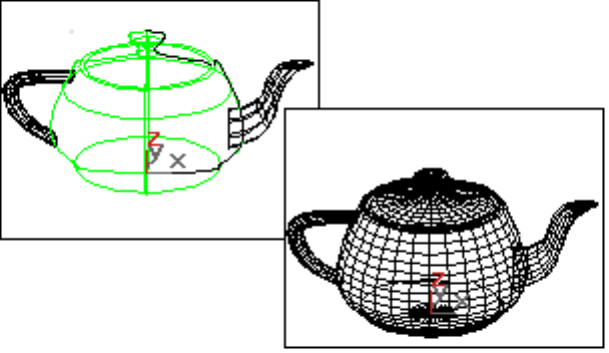
Iso Parametric Lines group
The controls in this group box affect the display of the NURBS surfaces in
viewports.
U Lines and V Lines The number of lines used to approximate the NURBS
surfaces in viewports, along the surface's local U and V dimensions,
respectively. Reducing these values can speed up the display of the surface,
but reduce accuracy of the display. Increasing these values increases accuracy
at the expense of time. Setting one of these values to 0 displays only the edge
of the object in the corresponding dimension.
Iso Only When chosen, all viewports display iso line on page 7822
representations of the surface. Iso (parametric) lines are similar to contour
lines. The lines show where the NURBS surface has a constant U value or V
value or both. Iso line representations can be less crowded and easier to
visualize than wire mesh representations.
Iso and Mesh (The default.) When chosen, wireframe viewports display iso
line representations of the surface, and shaded viewports display the shaded
surface.
Mesh Only When chosen, wireframe viewports display the surface as a wire
mesh, and shaded viewports display the shaded surface.
In wireframe viewports, this option lets you see the surface approximation
used for viewports.
Iso and mesh displays of a NURBS teapot
Curve and Surface Approximation | 2483
Viewports When chosen, the utility affects how surfaces in the NURBS
objects are displayed interactively in viewports, including shaded viewports,
and by the preview renderer.
The Viewports surface settings are also used when you apply a mesh modifier
such as Mesh Select to the NURBS objects. This is important because it can
affect the scene's geometry.
Renderer When chosen, the utility affects how surfaces in the NURBS objects
are displayed by the renderer, and by the draft renderer for Quick Render.
Base Surface When on, settings affect entire surfaces in the selection set.
Default=on.
Surface Edge When on, settings affect the tessellation of surface edges that
are defined by trim curves.
Displaced Surface Enabled only when Renderer is chosen. Turn on to set a
third, independent approximation setting for surfaces that have a displacement
map on page 5391 or Displace on page 1274 modifier applied to them.
Load Tessellation Preset group
Lets you choose a preset low, medium, or high-quality level of surface
approximation. While a preset is chosen, the values it uses are displayed in
the Tessellation Method group box.
Preset values are saved in the 3dsmax.ini file. You can customize the preset
values by using the buttons in the following group box, Save Tessellation
Preset.
Low Selects a (comparatively) low-quality level of surface approximation.
These are the default values:
Viewports, Base Surface:
Method=Spatial and Curvature
Edge=50.0
Distance=50.0
Angle=50.0
Merge=0.0
Advanced Parameters > Minimum=0, Maximum=3
Renderer, Base Surface:
Method=Spatial and Curvature
2484 | Chapter 10 Surface Modeling
Edge=20.0
Distance=20.0
Angle=15.0
Merge=0.01
Advanced Parameters > Minimum=0, Maximum=3
Renderer, Displaced Surface:
Method=Spatial and Curvature
Edge=20.0 Distance=20.0
Angle=10.0 Merge=(Unavailable)
Advanced Parameters > Minimum=0, Maximum=2
Medium (The default for both viewports and rendering.) Selects a
medium-quality level of surface approximation. These are the default values:
Viewports, Base Surface:
Method=Spatial and Curvature
Edge=20.0
Distance=20.0
Angle=15.0
Merge=0.0
Advanced Parameters > Minimum=0, Maximum=3
Renderer, Base Surface:
Method=Spatial and Curvature
Edge=10.0
Distance=15.0
Angle=10.0
Merge=0.01
Advanced Parameters > Minimum=0, Maximum=4
Renderer, Displaced Surface:
Method=Spatial and Curvature
Edge=10.0
Curve and Surface Approximation | 2485

Distance=10.0
Angle=4.0
Merge=(Unavailable)
Advanced Parameters > Minimum=0, Maximum=3
High Selects a high-quality level of surface approximation. These are the
default values:
Viewports, Base Surface:
Method=Spatial and Curvature Edge=5.0 Distance=15.0 Angle=10.0 Merge=0.0
Advanced Parameters > Minimum=0, Maximum=3
Renderer, Base Surface:
Method=Spatial and Curvature
Edge=5.0
Distance=5.0
Angle=3.0
Merge=0.01
Advanced Parameters > Minimum=0, Maximum=4
Renderer, Displaced Surface:
Method=Spatial and Curvature
Edge=5.0
Distance=5.0
Angle=2.0
Merge=(Unavailable)
Advanced Parameters > Minimum=0, Maximum=4
Save Tessellation Preset group
Click a button to save the current Tessellation Method settings as a new Low,
Medium, or High preset. These values are saved in the 3dsmax.ini file.
NOTE There is a separate Low, Medium, and High preset for Base Surface and
Displaced Surface approximation. Check whether Base Surface or Displaced Surface
is on before you use the buttons in this group box to save a custom preset.
2486 | Chapter 10 Surface Modeling

Customizing preset values overwrites the default presets. To restore the defaults,
you can re-enter the default preset values shown above, and then save them
with the corresponding button. You can also restore defaults by editing the
3dsmax.ini file to delete the custom preset values.
When you customize the preset values, there is no necessary correlation
between the button names and the quality of surface approximation. The
software has no way of knowing how "good" a tessellation is, and you can
save a very high-quality surface approximation in the Low preset, for example.
Tessellation Method group
The controls in this group box affect the display of the NURBS surfaces in
either viewports, if Viewports is chosen, or by the renderer, if Renderer is
chosen. You can choose between five algorithms. Each approximates NURBS
surfaces by tessellating them in a different way.
NOTE When Viewports is chosen, you must also choose Mesh Only in order to
see the effect of the Mesh Parameter settings in wireframe viewports.
Generally speaking, if the preset values you have chosen give good results,
you don't need to adjust the controls in this rollout further. Use them if you
encounter problems with the preset alternative.
Tips
■Viewport Tessellation: The tessellation method creates the mesh, so if you
modify the NURBS object with Mesh Select, choose the method that gives
the result you need. If you use modifiers heavily, Spatial or Parametric
might be better than Curvature, because of their regular tessellation.
Curvature-dependent tessellation can cause problems with some modifiers.
■Renderer Tessellation: Spatial and Curvature usually obtains the most
accurate rendering. Curvature can be the more efficient choice when you
render animated surfaces.
Regular Generates a fixed tessellation across the surface based on U Steps
by V Steps. Increasing these parameters increases accuracy at a cost of speed,
and vice versa, but in general this can be the quickest and least accurate way
to approximate a NURBS surface. Very low values for U and V Steps using the
Regular method usually doesn't provide good results. Model complexity
increases slowly as U and V Steps values increase.
Parametric Generates an adaptive tessellation based on U Steps by V Steps.
Low values for U and V Steps using the Parametric method often provide good
Curve and Surface Approximation | 2487
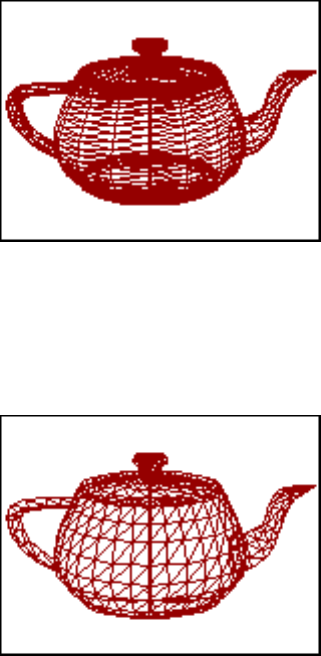
results. Model complexity increases rapidly as U and V Steps values increase,
so take care when you switch from Regular, which generally requires higher
U and V values, to Parametric, where lower U and V values generally suffice.
For example, if you convert a teapot to NURBS and set the U and V steps to
15, the Regular method generates 4470 faces but the Parametric method
generates 204960 faces.
Parametric mesh of the NURBS teapot
Spatial Generates a uniform tessellation made of triangular faces.
The Edge parameter specifies the maximum length of a triangular face in the
tessellation. The value is a percentage of the object's bounding box. Decreasing
this value increases accuracy but increases rendering time.
Spatial mesh of the NURBS teapot
Curvature Generates a variable tessellation based on the curvature of the
surface. The tessellation has a finer grain where the surface is more curved.
Changing surface curvature dynamically changes the curvature tessellation.
The Distance parameter specifies how far the approximation can deviate from
the actual NURBS surface. Distance is a percentage of the diagonal of each
2488 | Chapter 10 Surface Modeling
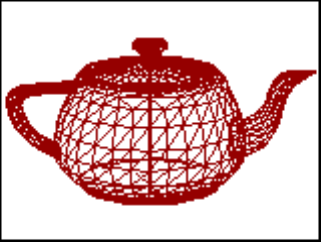
surface's bounding box. Each surface in an object is tessellated based on its
size, independently of other surfaces, and scaling a surface doesn't change its
tessellation. Decreasing this value increases accuracy but increases rendering
time. When you set Distance to 0.0, the software ignores this parameter and
uses the Angle to control accuracy.
The Angle parameter specifies the maximum angle between faces in the
approximation. Decreasing this value increases accuracy but increases rendering
time. When you set Angle to 0.0, the software ignores this parameter and uses
the Distance to control accuracy.
When both Distance and Angle are 0.0, the surfaces degenerate and can become
flat surfaces.
Curvature mesh of the NURBS teapot
Spatial and Curvature (The default.) Combines the spatial (edge-length)
method and the curvature (distance and angle) methods, using all three values.
The Edge parameter specifies the maximum length of a triangular face in the
tessellation. The value is a percentage of the object's bounding box. Decreasing
this value increases accuracy but increases rendering time. When you set Edge
to 0.0, the effect is equivalent to the Curvature method.
The Distance parameter specifies how far the approximation can deviate from
the actual NURBS surface. Distance is a percentage of the diagonal of each
surface’s bounding box. Each surface in an object is tessellated based on its
size, independently of other surfaces, and scaling a surface doesn’t change its
tessellation. Decreasing this value increases accuracy but increases rendering
time. When you set Distance to 0.0, the software ignores this parameter and
uses the Edge and Angle values to control accuracy.
The Angle parameter specifies the maximum angle between faces in the
approximation. Decreasing this value increases accuracy but increases rendering
Curve and Surface Approximation | 2489

time. When you set Angle to 0.0, the software ignores this parameter and uses
the Edge and Distance values to control accuracy.
When Distance, Angle, and Edge are all 0.0, the surfaces degenerate and can
become flat surfaces.
View-Dependent (for the Renderer only): When on, takes the object's distance
from the camera into account while calculating its tessellation. This can
improve rendering time by not generating fine-grained tessellations for objects
that are in the distance of the rendered scene. The view-dependent effect only
works when you render camera or perspective views. It doesn't work in
orthographic views. This control is disabled while Viewports is active.
For the Spatial, Curvature, and Spatial and Curvature methods, when
View-Dependent is on, the Distance and Edge values specify pixels instead of
the software’s default units.
NOTE When View-Dependent is on, tessellation very quickly reaches the maximum
subdivision limit. You might want to increase this value to 7 (the greatest value
allowed). See the description of Advanced Parameters, below.
Merge Controls the tessellation of surface sub-objects whose edges are joined
or very nearly joined. When input to a modifier (such as Mesh Select) that
requires a mesh, and when NURBS surfaces are tessellated for production
rendering, by default the software adjusts the tessellation of adjoining surfaces
to match each other, in terms of the number of faces along the edges. The
Merge parameter controls how this is done. If Merge is zero, adjoining faces
are unchanged. Increasing the value of Merge increases the distance the
software uses to calculate how edges should match, guaranteeing no gaps
between the surfaces when they are rendered. Default=0.01.
In most cases, you don't need to adjust Merge. If rendering shows gaps between
nearly adjoining faces, increase Merge to eliminate them.
Technically, the Merge value is one tenth of one percent of the diagonal of
the object's bounding box. In other words, a Merge value of 1.0 (higher than
necessary for most purposes) is 0.1 percent of the length of the diagonal.
Because Merge is based on the object's dimensions, you can scale the NURBS
model without affecting the Merge setting.
Advanced Parameters Click to display the Advanced Surface Approximation
dialog on page 2478 . The parameters in this dialog apply to the Spatial,
Curvature, and Spatial and Curvature approximation methods.
Clear Surfaces When on, the settings you choose in this utility override all
sub-object specific surface approximation settings in the selected NURBS
2490 | Chapter 10 Surface Modeling
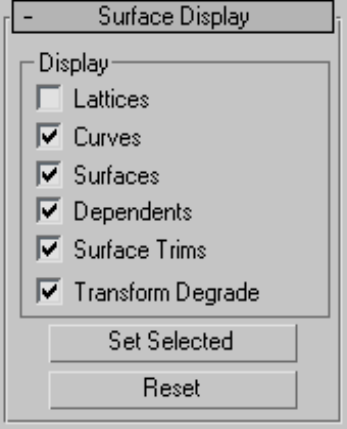
models. When off, the utility affects top-level NURBS models but settings local
to individual surface sub-objects remain unaffected. Default=Off.
Set Selected Applies the surface approximation values active in the utility
to all selected NURBS objects.
Reset Resets the values in the utility to the default settings for a NURBS
surface.
Surface Display Rollout
Utilities panel > Utilities rollout > More button > Utilities dialog > Surface
Approximation > Surface Display rollout
The controls in the Surface Display rollout are the same as the display controls
for NURBS surface objects, with two additional buttons: Set Selected and Reset.
Interface
Curve and Surface Approximation | 2491
Display group
Lattices When on, displays control lattices, in yellow lines. (You can change
the lattice color by using the Colors panel on page 7505 of the Customize User
Interface dialog. The Curve CV and Surface CV sub-object levels also have a
local Display Lattice toggle, which overrides this global setting at the sub-object
level. The Curve CV and Surface CV settings are independent. In other words,
at the sub-object level, you can turn on the lattice for an object’s curves but
not its surfaces, or vice versa.
Curves When on, displays curves.
Surfaces When on, displays surfaces.
Dependents When on, displays dependent sub-objects.
Surface Trims When on, displays surface trimming. When turned off, displays
all of a surface even if it’s trimmed.
Transform Degrade When on, transforming a NURBS surface can degrade
its display in shaded viewports, to save time. This is similar to using the
Adaptive Degradation toggle for playing animations. You can turn off this
toggle so surfaces are always shaded while you transform them, but transforms
can take longer to create.
Button set
Set Selected Applies the display settings active in the utility to all selected
NURBS objects.
Reset Resets the values in the utility to the default settings for a NURBS
surface.
Tools for Low-Polygon Modeling
A couple of utilities help you manage the polygon count for scenes and
animations that must not become too complex. Show Statistics, available from
the viewport right-click menu, lets you monitor the number of polygons,
vertices, etc., in the scene, as well as the frames per second displayed. The
Level of Detail utility, available from the Utilities panel on page 7463 , lets you
manage the complexity of an object in the scene. For example, Level of Detail
enables you to display a complex object as simple geometry when the object
is at a distance from the camera.
Show Statistics on page 2493
2492 | Chapter 10 Surface Modeling
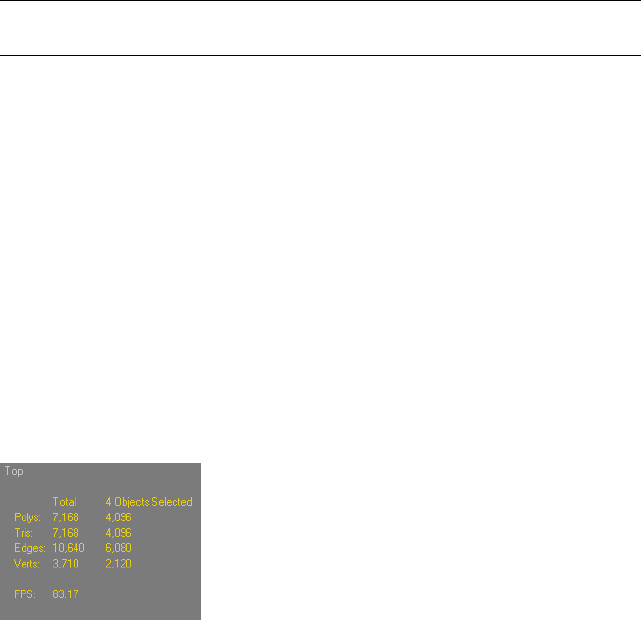
Level of Detail Utility on page 2494
Show Statistics
Right-click a viewport label. > Show Statistics
Keyboard > 7
You can quickly access various statistics related to your current selection and
entire scene.
NOTE These statistics are relevant primarily to mesh and poly objects. Some
statistics information might be unavailable with certain other types of object.
Procedures
To use the viewport statistics display:
1Customize the statistics display on the Customize menu > Viewport
Configuration dialog > Statistics panel.
2Activate the viewport in which to display statistics.
3Toggle the statistics display by pressing 7 or right-clicking the viewport
label and choosing Show Statistics.
Interface
You can customize the viewport statistics by turning on and off options on
the Statistics on page 7628 panel of the Viewport Configuration dialog. The
following statistics reflect all options turned on.
The first column lists the statistics for the entire scene, while the second only refers to
the selected objects.
Polys Displays the number of polygons in the scene and selection.
Show Statistics | 2493
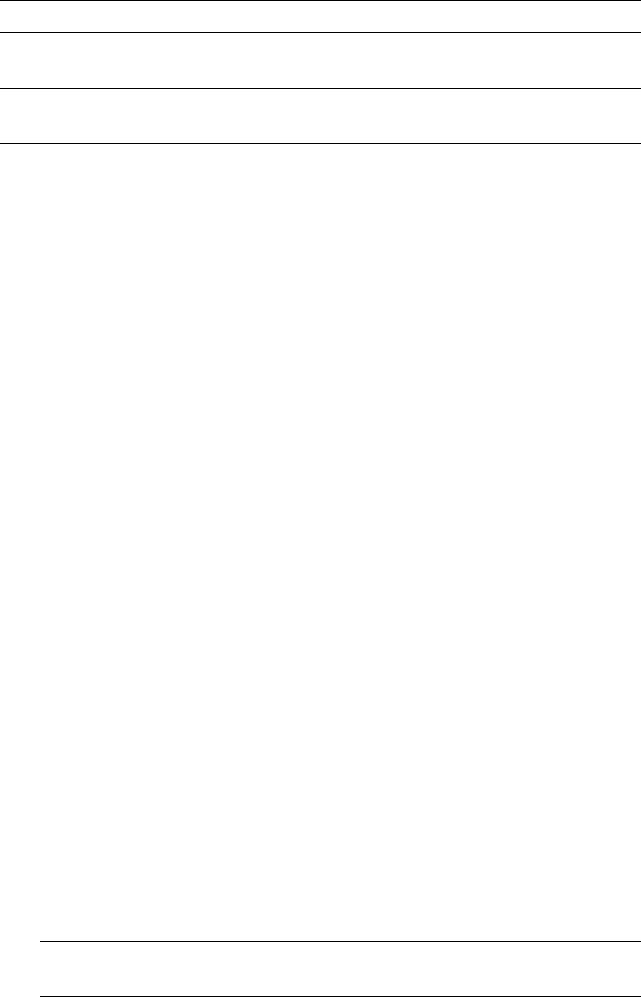
NOTE This is valid only for poly objects.
Tris Displays the number of triangle faces in the scene and selection.
NOTE If you select a polygon in a poly object, this option shows two or more
triangles.
Edges Displays the number of edges in the scene and selection.
Verts Displays the number of vertices in the scene and selection.
FPS The frames per second displayed in the viewport.
Level of Detail Utility
Utilities panel > Utilities rollout > More button > Utilities dialog > Level of
Detail
The Level Of Detail utility lets you construct an object that alters its geometric
complexity or level of detail based on its size in the rendered image. You create
several versions of the same object each with different levels of detail, group
them as one, and then run the Level Of Detail utility, which automatically
creates a special LOD controller as a Visibility track. The LOD controller then
hides and unhides the objects in the group, depending on their size in the
rendered scene.
The main purpose of this utility is to save time in rendering complex objects
and in manipulating objects in the viewports. Since a portion of rendering
speed is directly related to the number of faces that must be rendered in a
scene, using the Level Of Detail utility lets you reduce the number of rendered
faces as an object reduces its apparent size. In addition, you can use this utility
to display a simple stand-in for a more complex object in the viewports. Since
the stack is not calculated for objects hidden in the viewports, you can speed
up viewport manipulation by using this utility to substitute complex stack
objects with simple stand-ins.
Procedures
To set up an object for the Level Of Detail utility:
1Create two or more objects that are identical except for their complexity.
NOTE It's best to assign materials and mapping coordinates, as well as all
modifiers while the objects are still separate.
2494 | Chapter 10 Surface Modeling

2Select all of the objects, and use the Align tool to center all of them about
a common center.
3Group the objects.
4Choose the Level Of Detail utility.
5While the grouped object is selected, click the Create New Set button.
The name of the objects within the group appear in the Level Of Detail
list, in order of complexity; only the least complex object in the group
is displayed in the viewports, while all other objects are made invisible.
6Use the controls in the Level Of Detail rollout to adjust when the objects
will switch their display in the rendered scene.
To access an object's stack:
1Select the Level Of Detail object, and then choose Group menu > Open.
2In the Level Of Detail utility, choose the object you want to access from
the list window, and then turn on Display In Viewports (or double-click
the object's name in the list window).
3Select the object in the viewport.
4Open the Modify panel to access that object's parameters.
5When finished, choose Group menu > Close.
To assign materials within the group:
1Select the grouped object.
2Use Display In Viewports in the Level Of Detail utility to display the
grouped object you want to assign the material to.
3Drag the material from the Material Editor (or the Browser) over to the
object in the viewport.
4Choose Assign To Object in the Assign Material alert, and then click OK.
NOTE Be sure and choose Assign To Object. If you choose the default Assign
To Selection, all objects in the group will be assigned the same material.
Level of Detail Utility | 2495
To dismantle a Level Of Detail object:
If you look at a Level Of Detail object in Track View, you'll see only the tracks
for the sub-object that's currently displayed in the viewports. To see all
sub-objects in Track View, you need to turn off Visible Objects.
If you need to dismantle a grouped Level Of Detail object, and restore its
sub-objects to their independent states, follow these steps:
1Open the Filters dialog in Track View, and turn off Visible Objects in the
Show Only group box.
2The tracks for all of the sub-objects in the Level Of Detail object are now
visible.
3Open the hierarchy of each of the sub-objects, and then select each of
their Visibility tracks.
4On the Track View toolbar, click the Delete Controller button.
5If you also want to remove the grouping, select the grouped objects, and
then choose Explode in the Group menu.
2496 | Chapter 10 Surface Modeling

Interface
Level of Detail Set group
Lets you create a new set, and add or remove objects from the current set.
Level of Detail Utility | 2497
Create New Set Creates a new Level of Detail set based on a currently selected
group object.
Add To Set Adds an object to the Level of Detail set. You must first attach
the object you want to add to the group object. To add an object to the set,
use Align to center the object with the group object. Select the object you
want to add, and then choose Attach from the Group menu, and then click
the group object. Finally, click the Add to Set button, and then click the object
you want added.
Remove from Set Removes the object highlighted in the list window from
the current set. Note that the object then becomes visible in the viewports,
but is still part of the group. To remove the object from the group, choose
Group menu > Open, select the object you want removed, and choose Group
menu > Detach. Select the group object again, and choose Group menu >
Close.
Image Output Size group
Width/Height The Width and Height spinners in this area are set to the
current rendering output size each time you enter the Level of Detail utility.
Using the spinners, you can change this to any resolution. If the percent of
Target Image option is selected, as you change the Target Image Size, the
threshold values change as well.
Reset to Current Resets both spinners to the current rendering output size.
List window Lists all of the objects in the group by complexity, with the
least complex at the top of the list. The numbers at the left of each object
name are the threshold values that indicate at what size the object will be
displayed in the rendered scene. The numbers can be one of two types of units,
pixels, or percentage of the target image. You set the type of unit in the
Threshold Units group.
Display in Viewports Displays in the viewport the object highlighted in the
list window. Only one object in the group is displayed in the viewports at any
time. As a default, the least complex object is displayed, but you can look at
the other objects by highlighting them in the list and selecting this item.
Double-clicking the object name in the list performs the same function.
Threshold Units group
The options in this group box let you choose between two types of threshold
units. Switching between these two options does not alter the effect; it alters
the method by which you set the thresholds.
2498 | Chapter 10 Surface Modeling

Pixels The thresholds are determined by specifying the maximum pixel size
of the image (measured diagonally). Use when you want to set the transfer
thresholds using absolute rather than relative values.
% of Target Image Sets the thresholds based on the percentage of the size
of the image (measured diagonally) relative to the size of the rendered output.
Thresholds group
Min Size/Max Size Sets the minimum size of the object before it's replaced
by the less complex object, and the maximum size of the object before it's
replaced by the more complex object. The values vary depending on the
current type of Threshold Unit. The default threshold values are initialized so
that the most complex object is 100 percent of the image output size. The
remaining thresholds are set using an algorithm based on a ratio of the number
of faces between each object. It assumes that all faces are the same size, and
then picks thresholds so that the faces would remain a constant size as
displayed on the screen. Usually, this will provide the type of smooth transition
you need, but you can customize the threshold values. The threshold values
are interrelated between the objects, so altering the minimum size of one
object, for example, will also alter the maximum size of the next object.
Reset All Resets all thresholds for all objects in the list, using the previously
described algorithm.
TIP You can use the Level of Detail utility to create objects that display very simple
geometry in the viewports, while displaying complex geometry in the rendered
scene. Create a grouped Level of Detail object consisting of only two objects, the
complex object and the simple object. Select the simple object in the list window
and, in the Thresholds are, set its Min Size and its Max Size to 0. This will display
the simple object in the viewports, but the complex object will always appear in
the rendered scene, regardless of its apparent size.
Close button
Close Closes the utility.
Level of Detail Utility | 2499
2500
Precision and Drawing
Aids
3ds Max provides tools that give you control over the positioning and alignment of objects
in 3D space. With these tools, you can do the following:
■Choose display units from the most common real-world measuring systems or define your
own.
■Use the home grid as a construction plane, or use grid objects to position custom
construction planes.
■Select different options to align objects with grids, points, and normals.
■Use 3D object snaps on a modeless dialog as you build and move geometry in your scene.
Grid points and lines are among the many snap options.
■Use "helper objects" in your work. This category includes grid objects as well as objects
used for positioning and measurement.
This section presents these brief topics designed to help you quickly start learning how to use
the tools that make precision possible:
Tools for Precision on page 2502
Using Units on page 2504
Using Grids on page 2506
Using the Home Grid on page 2507
Using Grid Objects on page 2510
Aligning Objects on page 2516
Aligning Normals on page 2520
Setting Standard Snaps on page 2521
Setting Snap Options on page 2523
11
2501
Measure Distance Tool on page 2529
Tools for Precision
A set of interrelated tools in the program gives you precise control of the scale,
placement, and movement of objects in your scene. These are especially
important tools for those who build precise models in real-world units of
measurement.
Basic Tools
The tools for precision are grouped as follows:
Units Define different measurement systems. Besides the generic unit, you
have your choice of feet and inches in both decimals and fractions. Metric
units range from millimeters to kilometers. You can also define other units.
Grids Include the home grid and special grid objects. Both types of grid can
act as construction planes. The software constructs objects using the orientation
and position of the active grid. While the home grid is fixed in world space,
you can rotate grid objects and place them anywhere in a scene, and align
them to other objects and surfaces. You can also give each grid object its own
spacing, and display any grid as a dedicated viewport.
Object alignment Matches an object with the position, orientation, or normal
of another object, or to a point in space.
Object snaps Ensure precise placement when creating and rearranging objects.
Keyboard shortcuts let you change object snaps as you work. You can also set
snaps to find grid lines and intersections. An angle snap sets the increment
for rotation, and a percent snap sets the increment for scaling.
Helpers Provide useful assistance, as the name implies. These are specialized
tools in the same category as grid objects. A Tape object measures distances
in current units, and a Protractor object measure angles. A Grid object defines
a construction plane, and a Point object marks a particular spot in 3D space.
2502 | Chapter 11 Precision and Drawing Aids

How the Tools Work Together
The tools themselves establish a general order of use and interaction, although
you can always change settings as needed without following this sequence.
■Choose a measuring unit. The default is generic units, sufficient for many
purposes.
■Set grid spacing (the size of the smallest square), based on the measuring
unit. The home grid and grid objects can have their own spacing, separate
from the grid spacing.
■Move and align grid objects to a useful orientation.
■Set or vary snap settings as needed in your work.
■Use other helper objects like Point and Tape as part of the precision process.
As you work, you can change your settings (including the measuring unit)
without losing any precision.
Helpers
Create panel > Helpers
Create menu > Helpers
Helper objects play a supporting role, like stage hands or construction
assistants.
Several categories of helpers are available from the drop-down list on the
Create panel:
Standard helpers on page 2530
Atmospheric Apparatus on page 6560
Camera Helper on page 5157
Assembly Head Helper Object on page 234
■Character Assembly on page 217
■Luminaire Helper Object on page 235
Manipulator Helper Objects on page 2552
Helpers | 2503
Particle Flow ( Speed By Icon Operator on page 2796 and Find Target Test on
page 2891 )
VRML97 Helper Objects on page 7093
reactor on page 3803
Other helper objects might be available, depending on your configuration.
Using Units
Units are the key to connecting the three-dimensional world of 3ds Max with
the physical world. You define the units you want to use from the Units Setup
dialog on page 7601 .
Changing Display Units
When you change display units, 3ds Max displays measurements in the new
unit for your convenience. All dimensions are displayed in the new unit.
Essentially, you’re using a new "measuring stick." No object is changed in this
process. As in the physical world, objects in the scene maintain their absolute
size, regardless of how you measure them.
Type-In Entry
When you enter any dimension, 3ds Max always assumes the number you
enter is expressed in the current units. You can also enter a series of numbers:
3ds Max then converts their sum into the current unit. Here are some examples
that assume the current units are in centimeters:
■When you enter a dimension of 1’ (one US foot), it converts to 30.48cm.
■If you enter a series of numbers such as 14 286 175 (separated by spaces),
the series is totaled to 475.0cm.
■If you enter 1’ 1 (one US foot and 1 centimeter), this is converted and
summed into 31.48cm.
When you use US Standard as the display unit scale, you can select either feet
or inches as the default for type-in entry. If you select feet and enter 12, the
result is 12’ 0". However, if you enter 1’ 2, the software identifies the second
digit as inches, producing 1’ 2" as the result.
2504 | Chapter 11 Precision and Drawing Aids
In any unit system, you can enter fractional amounts. For example, assume
you’re working in US Standard with feet as the default:
■If you enter 18/3, the result is 6’0".
■If you enter 18/3", the result is 0’6".
■You can specify units in a different system, and they are converted on the
fly. For example, if you enter 18/3cm, the result is 0'2.362".
Understanding the System Unit
3ds Max keeps track of all measurements in its own internal system unit. No
matter what kind of display units you use, measurements are stored in this
absolute unit for storage and computation. The default system unit is defined
as 1.000 inch. As long as the system unit is left at one inch, y ou can freely
share models and change units on the fly with no effect on the underlying
geometry. Except in rare circumstances, you never need to change this default
scale. This means you can merge a model created with any standard unit into
your scene at true scale.
You can change the system unit setting on the System Unit Setup dialog,
available from the Units Setup dialog on page 7601 . Changing the system unit
is recommended only if your scene has very small (less than one inch) or very
large dimensions. See System Unit Setup Dialog on page 7605 for more
information.
If you do need to change the system unit, change it before you create or import
geometry. Do not change the system unit in an existing scene.
Using Units | 2505
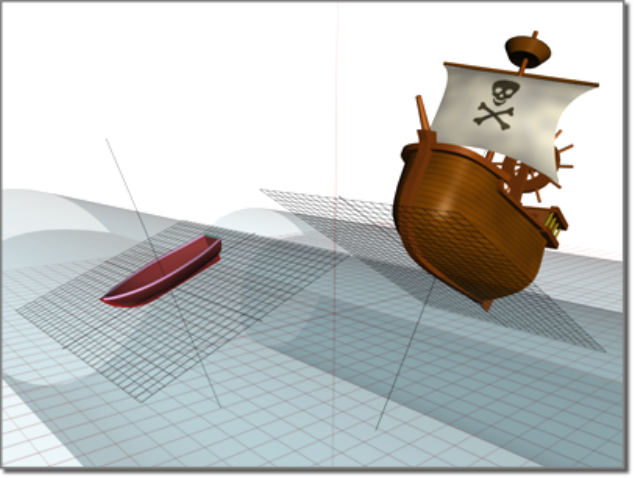
Using Grids
One grid establishes the pitch of the boat, another the pitch of the ship
Grids are two-dimensional arrays of lines similar to graph paper, except that
you can adjust the spacing and other features of the grid to the needs of your
work.
Grids have these primary uses:
■As an aid in visualizing space, scale, and distance.
■As construction planes where you create and align objects in your scene.
■As a reference system for using the Snap feature to align objects .
Home Grid and Grid Objects
3ds Max provides two kinds of grids: the home grid and grid objects. In
addition, it includes the AutoGrid feature, an automated way of creating grid
objects.
2506 | Chapter 11 Precision and Drawing Aids
Home grid The home grid is defined by three planes along the world X, Y,
and Z axes. Each of these axes passes through the world coordinate system's
origin point (0,0,0). The home grid is fixed; it cannot be moved or rotated.
■The home grid is visible by default when you start 3ds Max, but its display
can be turned off.
■You can use any view of the home grid as a construction plane by drawing
in the viewport in which the grid's view appears.
See Viewing and Navigating 3D Space on page 55 for a complete introduction
to the home grid.
Grid objects A grid object is a helper object you can create whenever you
need a local reference grid or construction plane somewhere other than the
home grid.
■You can have any number of grid objects in your scene, but only one can
be active at a time.
■When active, a grid object replaces the home grid in all viewports.
■Each grid object has its own set of XY, YZ, and ZX planes. You can freely
move and rotate grid objects, placing them at any angle in space, or attach
them to objects and surfaces.
■You can change a viewport to display a plan (top) view of any active grid
object.
■Grid objects can be named and saved like other objects, or used once and
deleted.
AutoGrid This feature lets you create new objects and grid objects off the
surfaces of other objects on the fly. See AutoGrid on page 2513 .
Using the Home Grid
The home grid provides ready-to-use construction planes, much like a leveled
building site marked with stakes and strings. When you create an object in a
viewport, the new object is placed on the home grid plane of that viewport.
To use the home grid effectively for construction, you often need to change
the defaults to the job at hand, analogous to moving the stakes and strings
to match your own site plan.
Using the Home Grid | 2507
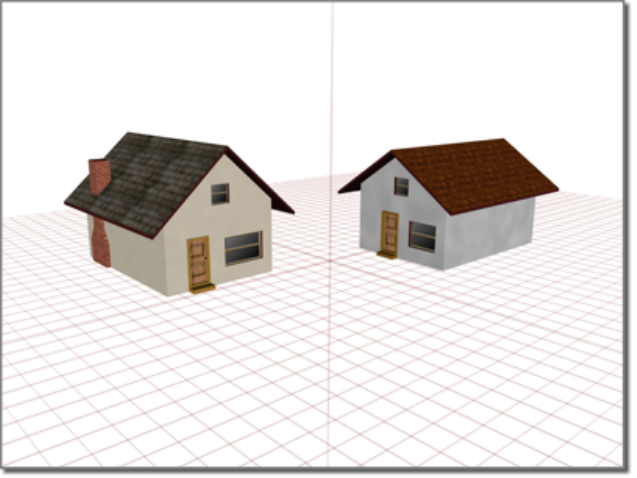
Using the home grid to position houses
Changing Home Grid Settings
The home grid is a single system; its three planes use the same settings for
grid spacing and major line divisions. You change these settings from a single
panel of the Grid and Snap Settings dialog.
To access the Home Grid panel, do one of the following:
1Choose Customize menu > Grid And Snap Settings, then click the Home
Grid tab.
2Right-click any snap button on page 2567 , then click the Home Grid tab.
Setting Grid Spacing
Grid spacing is the size, in current units, of the grid's smallest square. The
basic idea is to choose a grid spacing that corresponds to your unit of
measurement, then choose a larger spacing for multiple units.
For example, if you have units set to centimeters, you might make one grid
space equal to 1.000 (one unit, or one centimeter in this case).
2508 | Chapter 11 Precision and Drawing Aids
Setting Major Grid Divisions
The home grid displays heavier or "major" lines to mark groups of grid squares.
You can use these to represent larger units of measurement.
For example, if you use a grid spacing of one centimeter, you might use a
value of 10 so the major grid divisions represent one decimeter.
Setting Color and Intensity
To improve grid visibility, you can change the intensity or color of the home
grid. Choose Customize menu > Customize User Interface > Colors panel on
page 7505 .
Using the Home Grid | 2509
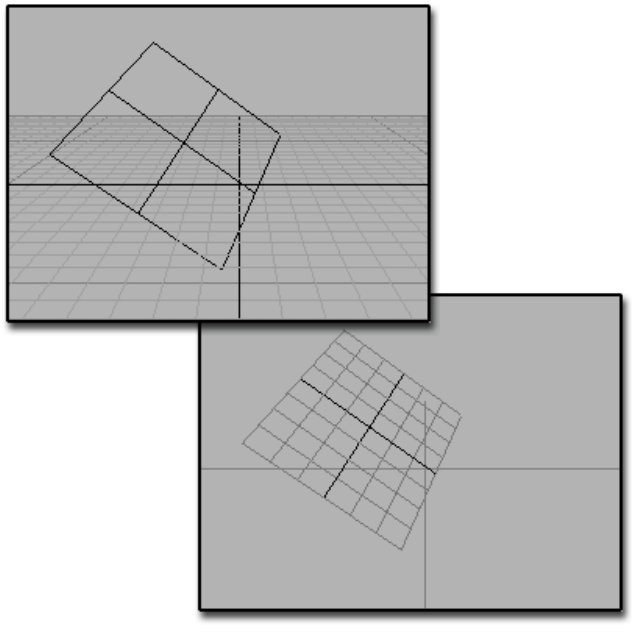
Using Grid Objects
Above: Inactive grid object in a scene
Below: Activated grid object
Grid objects let you bypass the home grid and work on separately defined
grids to create and position objects. You can use as many grid objects as you
like, each serving as a custom construction plane with its own grid settings.
Grid objects are 2D parametric objects, with adjustments for overall size and
grid spacing. You can adjust their orientation in world space, and match them
to a particular surface or object.
2510 | Chapter 11 Precision and Drawing Aids
To activate a grid object:
1Create or select a grid object.
2Choose Views > Grids > Activate Grid Object.
To deactivate a grid object, do one of the following:
■Select and activate another grid object.
■Choose Views > Grids > Activate Home Grid.
■Delete the grid object.
Creating and Modifying Grid Objects
You find Grid objects in the Create panel > Helpers category.
When creating an object, you can also create a temporary "AutoGrid" grid
object that's tangent to an existing object surface at the point you click. To
do this, turn on the AutoGrid on page 2513 check box in the Object Type
rollout. You can save this grid by holding the Alt key before you click.
Grid objects are named when you create them and are saved with the scene.
You can delete them at any time.
Like other objects created in 3ds Max, standard grid objects are placed on the
grid of the current viewport. By default, this is a plane of the home grid, but
can also be another activated grid object.
For more information on grid object settings, see Grid on page 2538 .
Viewing Grid Objects
An activated grid helper object on page 2538 creates a true plane in 3D space.
No matter how small an activated grid object appears on the screen, its plane
is effectively infinite, just as if it were a plane of the home grid. However, you
can view a given grid object in different ways.
Setting the Display Plane
You can adjust the visible plane of a selected or activated grid object on the
Modify panel.
Viewing Grid Objects | 2511
To set the display plane:
1Open the Modify panel to display the Parameters rollout for the selected
grid.
2In the Display group, choose any of the three planes: XY, YZ, or ZX.
The grid rotates in world space to display the corresponding plane, always
based on the grid's local axis.
You can move or rotate a grid, either before or after setting its display plane.
Setting Grid Views
You can set the view in any viewport to an orthographic view as well as the
display view.
To set grid view:
1Activate the grid object. on page ?
2Right-click a viewport label and choose Views > Grid to display a menu
of possible views.
3Choose Front, Back, Top, Bottom, Right, Left, or Display Planes. Display
Planes corresponds to the current setting on the Parameters rollout (XY,
YZ, or ZX).
The viewport now shows this view of the grid.
You can set different viewports to different views of the grid. Objects are always
created on a view's orthographic grid, even if you rotate the angle of view.
In other words, you can set up a convenient view and still construct on the
chosen plane.
Deactivating Grid Objects
You can deactivate a grid object in any of the following ways:
■Select and activate another grid object.
■Choose Views > Grids > Activate Home Grid.
■Delete the grid object.
When you deactivate a grid object, any viewports based on that grid switch
to the corresponding orthographic view. For example, a Grid (Front) viewport
2512 | Chapter 11 Precision and Drawing Aids
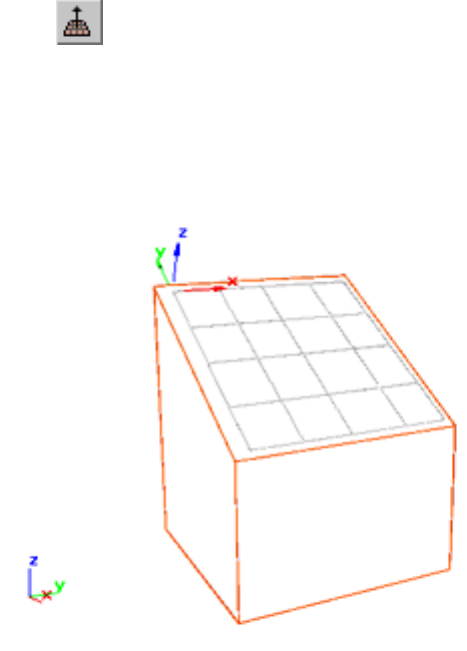
becomes a Front viewport. A Grid (Display Planes) viewport always switches
to Top view, regardless of the currently displayed plane.
AutoGrid
Create panel > Any object category > Object Type rollout
Extras toolbar > AutoGrid
AutoGrid | 2513
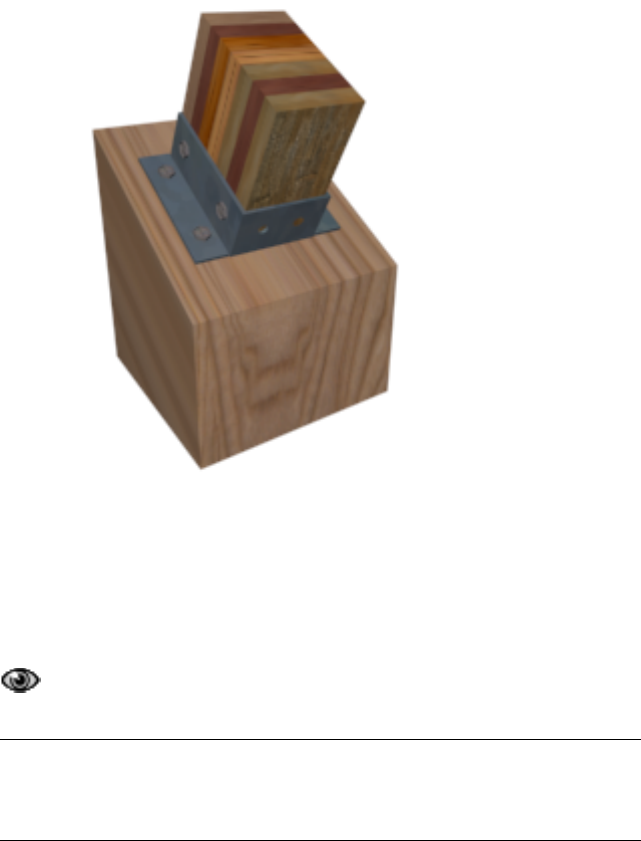
AutoGrid used to position the second block on top of the first
AutoGrid lets you automatically create, merge, or import objects on the surface
of other objects by generating and activating a temporary construction plane
based on normals of the face that you click. This serves as a more efficient
way of stacking objects as you create them, rather than building objects and
then aligning them as a separate step.
You can use objects within an XRef scene as reference when AutoGrid
is on.
NOTE If the Smooth check box is turned on in the Parameters rollout of a
parametric object, the construction plane is placed tangent to the face of the
surface implied by any smoothing present on the surface, not the actual face of
the surface.
2514 | Chapter 11 Precision and Drawing Aids
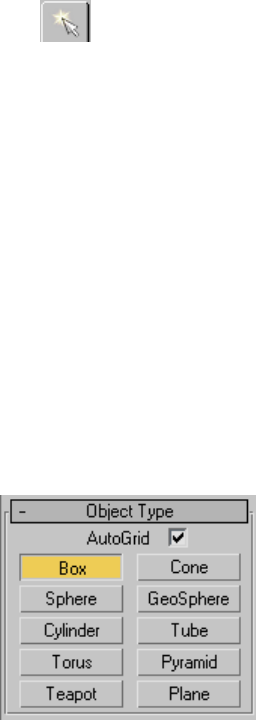
Procedures
Example: To create a box aligned to another object using a temporary
construction grid:
1Create or load a scene containing an object to which you want to align
a new box .
2 On the Create panel > Standard Primitives > Object Type rollout,
click Box.
3Turn on AutoGrid .
4Merge the object you want aligned.
5Move your cursor over the object to which you want to orient the box
you are about to create .
The cursor includes an X,Y,Z tripod to help you orient the position of
the new object. As you move over the object, the cursor aligns the Z axis
to the surface normal.
6When the orientation is as you want it, click and use the standard
drag-release-move-click method to create the box. The box will be created
on the designated surface.
When you click, a temporary, automatic grid is created, and the newly
created object is aligned to that grid.
Interface
Object Type rollout
AutoGrid AutoGrid is available only after you select an object button (such
as Box). When you turn AutoGrid on, the cursor includes an axis tripod to
AutoGrid | 2515

help you orient the grid. Before clicking and as you position the cursor over
a visible mesh object, the cursor jumps to the nearest point on that surface.
The tripod's X and Y axes form a plane tangent to the object surface (forming
an implied construction grid), and the Z axis is perpendicular to the plane.
After creating the object, 3ds Max places it on the temporary construction
grid. When creating an object, if the cursor isn't over another object, 3ds Max
places the object on the current active grid.
TIP When you create an object that requires multiple clicks, AutoGrid applies only
to the first click. So, for instance, if you want to create a Line spline on page 551
that snaps to the faces of a sphere, turn on Snaps on page 2568 (press the S key),
and then open the Grid And Snap Settings dialog on page 2578 and turn on Face.
NOTE To make the grid permanent, hold down the Alt key before you click. The
grid becomes active and 3ds Max turns AutoGrid off.
Aligning Objects
You can align a selection consisting of one or more objects, called the source,
with a target object. There are many uses for this feature. For precision, an
important use is grid alignment. You can create a new grid object and align
it to an existing object, either manually after creation or automatically during
creation using the AutoGrid on page 2513 feature. Conversely, you can move
an object onto a grid anywhere in your scene.
2516 | Chapter 11 Precision and Drawing Aids
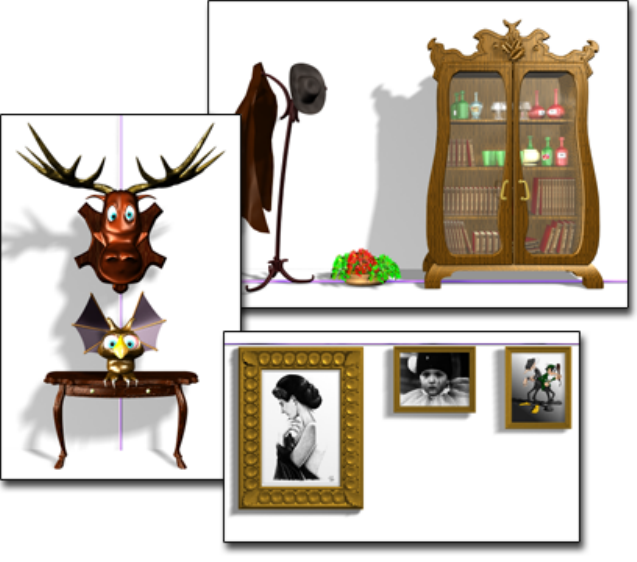
Aligning objects by the center, bottom, or top of their bounding boxes
Source and Target Objects
Alignment involves two entities: one is the source object or selection set,
where the process begins; the other is the target object, where the selection
process ends.
Source object Object or objects you want to move into alignment with
another object. You select one or more source objects to begin the alignment
process.
Target object Object used to define the alignment. You select the target
object during the alignment process. It cannot be selected beforehand.
After selecting the source, choose Tools menu > Align or click the Align button
on the Main toolbar, and then select the target object.
Next, the Align dialog appears. For discussion of the Align options, see Align
on page 938 .
Aligning Objects | 2517
Setting a Coordinate System
The effects of alignment depend on the current reference coordinate system,
such as View, World, or Local. You should decide which system you want to
use before beginning alignment.
Reference Coordinate System Determines the axes used for positional
alignment and the size of the bounding box for maximum and minimum
positions.
To align objects using active grid axes:
■Choose Grid as the reference coordinate system from the list on the toolbar.
To align two objects using their own axes:
■Choose Local as the reference coordinate system. Alignment is then strictly
between the two objects. Object bounding boxes determine maximum
and minimum positions.
As a reminder to you during the alignment process, the current reference
coordinate system appears in parentheses following the Align Position label
in the Align Selection dialog.
Basics of Aligning Objects
Alignment controls are on a single dialog. As you make a setting, the object
being aligned moves immediately to the new position. This lets you experiment
with alignment until you get what you want. Settings can be made in any
order.
You can also work step-by-step, by applying position choices, for example,
before deciding on final orientation. You can cancel at any time, returning
the scene to its original state. You can also undo any alignment and start over.
2518 | Chapter 11 Precision and Drawing Aids
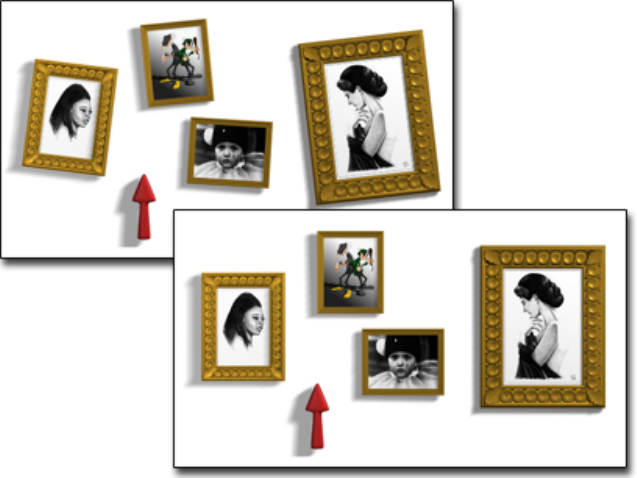
Aligning Multiple Objects
Aligning multiple objects to the arrow object (each photo is adjusted in a different
correction)
When you select multiple objects for alignment, the same settings apply to
all of them. However, the effect on each source object can be different. In
practice, you're aligning separate objects at the same time with the same
settings.
To align a collection of objects as a single unit, select the objects and group
on page 206 them. The alignment now takes place relative to the pivot and
bounding box of the entire group.
Sub-Object Alignment
You can use Align with any selection that can be transformed. The tripod axis
becomes the source for alignment. You do this by accessing the sub-object
level of the object before clicking Align.
Aligning Objects | 2519
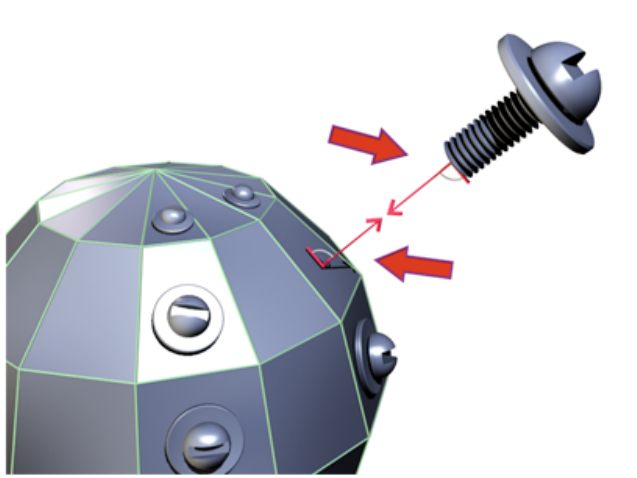
Aligning Normals
Normal on the front of the bolt is aligned with the normal of a face on the assembly.
3ds Max lets you align the normals between any two objects. In the case of
mesh objects, the alignment is between individual faces, because each face
has its own normal. See Normal Align on page 945 .
Basics of Aligning Normals
Before you begin, select a view that lets you see both objects you want to align.
If necessary, you can navigate the view after selecting the first normal. To see
face normals clearly, work in a wireframe viewport.
For details on the procedure and dialog settings, see Normal Align on page
945 .
Other Align Options
The Align flyout on the main toolbar has other buttons that provide specialized
alignments.
2520 | Chapter 11 Precision and Drawing Aids
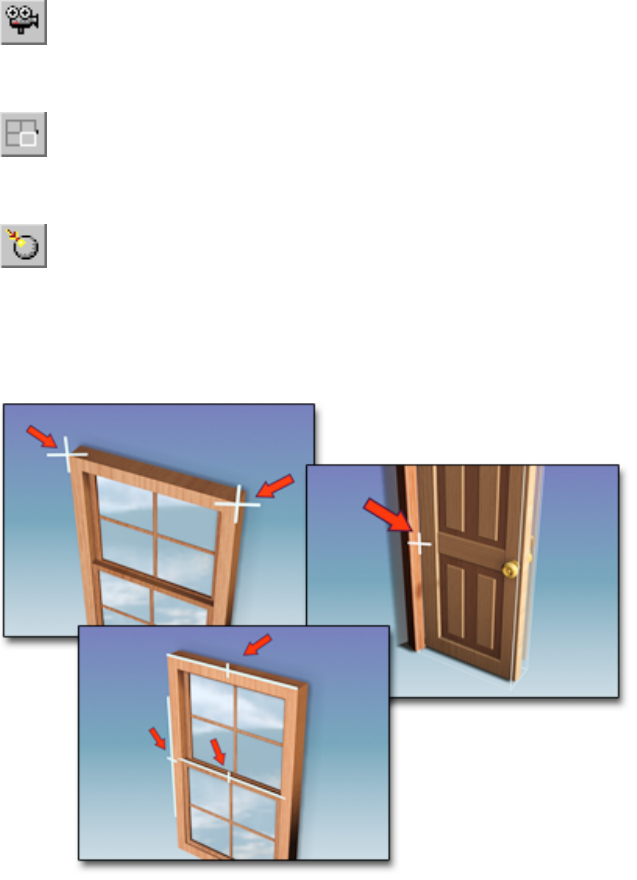
Align Camera Orients a camera viewport to a selected face normal,
with the normal in the center of the viewport and on the axis of the camera.
See Align Camera on page 950 .
Align to View Orients a local axis of an object or sub-object selection
with the current viewport. Options on the dialog are interactive, as they are
on the Normal Align dialog. See Align to View on page 951 .
Place Highlight Orients a face normal to a light. See Place Highlight
on page 948 and Lighting in 3ds Max on page 4904 .
Setting Standard Snaps
Snapping to: endpoints, midpoints, edges
Setting Standard Snaps | 2521

Standard snaps give you control in creating, moving, rotating, and scaling
objects. You access the snap features in the program from buttons on the main
toolbar .
You make most snap settings on Grid And Snap Settings, a modeless dialog
with four panels. You can move this dialog to any convenient location on
your screen and turn options on and off as you work. Panels are reset to
defaults for each new session.
You can also make commonly used snap settings on the Snaps toolbar on
page 2579 .
Snap settings are stored in the 3dsmax.ini on page 51 file rather than in the
MAX file. This means that the state of the snap settings persists from session
to session without your having to modify the maxstart.max file.
Grid And Snap Settings Dialog and Snaps Toolbar
The most commonly used grid and object snaps appear on the Grid and Snap
Settings dialog on page 2577 . This is the general sequence for using these snaps:
1 Turn on snapping by clicking the Snaps Toggle button on the main
toolbar, and then right-click this button to display the Grid And Snap
Settings dialog.
Two sets of snap types are available: Standard (the default) and NURBS.
Both are discussed in Snap Settings on page 2578 .
You can also make commonly used snap settings on the Snaps toolbar
on page 2579 .
2Turn on OSNAPS on the status bar, then right-click this button to display
the Grid and Snap Settings dialog.
3By default, only the Grid Points snap type is active. Turn on other snap
types to activate them. When you create or move objects, these snaps
are now in effect anywhere in 3D space, and unaffected by the current
transform coordinate system.
As you move the cursor, each snap type is marked by a distinctive icon
shown on the Snap panel. The current icon indicates the type and position
of the next snap.
Grid points and grid lines are secondary to the other snap types. For
example, if both Grid Point and Vertex are active, the software snaps to
a vertex in preference to an equally close grid point.
2522 | Chapter 11 Precision and Drawing Aids

4Turn snaps on and off as needed; the easiest way is by pressing the S key.
For more information on snaps, see 2D Snap, 2.5D Snap, 3D Snap on page
2568 and Snap Settings on page 2578 .
Snap Override
Snap Override bypasses currently selected snaps. You use a keyboard-mouse
combination or a keyboard shortcut to define a new snap for the next click.
You can override on the fly, one snap at a time.
For example, while creating a spline between grid points, you might need to
snap to a vertex or midpoint of an object. This is the general procedure:
1As you use preset snaps to create or move an object, hold down Shift and
right-click. This pops up a three-quadrant right-click menu, which you
can use to override the current snap setting(s).
NOTE You can begin the creation or transformation process before accessing
the override menu. This typically means that you'll be holding down the left
button as you Shift+right-click.
2From the Snap Override quadrant, choose the snap type you want to use.
The cursor switches to this type.
3Make the snap. After the snap, currently set snaps are back in effect.
In addition, the Snap Override quadrant lets you reuse the last override you
used (listed by name), and gives you an option for None. None turns off
snapping entirely on the next click. The Snap quad menu also contains an
Options quadrant, with toggles for snapping within current transform
constraints (default=off) and snapping to frozen objects (default=off).
Setting Snap Options
You can access a number of snap features from the Options tab of the Grid
and Snap Settings dialog. Right-click any of the snap buttons on the main
toolbar to display the Grid And Snap Settings dialog or choose Customize
menu > Grid And Snap Settings, then click the Options tab.
Setting Snap Options | 2523
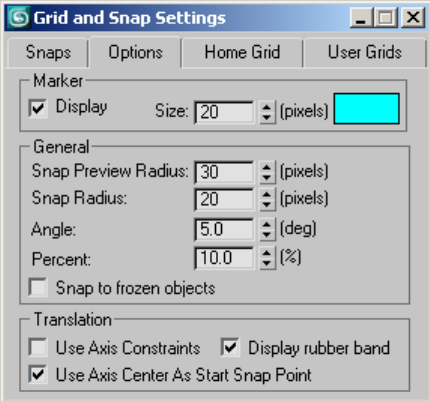
See also:
■Snap Options on page 2587
Display and General Settings
Marker settings Determine the color and size of the snap cursor. To prevent
the snap cursor from appearing, turn off Display.
Snap Radius settings Determines how close the cursor needs to approach a
snap point before the snap preview or actual snap takes place. These are global
settings, affecting all snap interactions, and are measured in terms of the pixels
in a "search region" around the active point of the cursor.
Snap to Frozen Objects Normally, if an object is frozen you can't snap to it;
this option lets you snap to frozen objects.
Settings for Angle and Percent Snap
The following Options settings are for two snap buttons that operate
independently of standard snaps.
Angle (deg) A global setting, in degrees, that determines the angle of rotation
for a number of features in the program, including the standard Rotate
transform. As you rotate an object (or group of objects), the object moves
2524 | Chapter 11 Precision and Drawing Aids

around a given axis in the increment you set. Angle snap also affects the
following:
■Pan/Orbit camera controls
■FOV and Roll camera settings
■Hotspot and Falloff light angles
For more information, see Angle Snap on page 2570 .
Percent Sets a percentage increment during a scaling operation.
For more information, see Percent Snap on page 2571 .
Rotating and Scaling with Snaps
The effect of rotating and scaling with snaps depends on whether Auto Key
on page 7344 is on or off:
■With Auto Key on, snap toggles are disabled, while Angle and Percent snaps
remain active. Rotation and scaling occur around the pivot point of the
object.
■With Auto Key off, rotations and scales occur around the snap point. For
example, using Vertex snap, you can rotate a box about any of its corners.
Translation Options
By default, the Use Axis Constraints on page 884 option is off. The current
setting on the Axis Constraints toolbar (XY, for example) has no effect. Turning
on this option lets you use snaps in conjunction with axis constraints.
The Translation group also lets you toggle display of a rubber band line between
the start and end points during a snap operation.
Settings for Spinner Snap
You set the spinner snap on the General panel on page 7536 of the Preferences
dialog. Right-click the Spinner Snap button on the main toolbar to display
this panel.
Spinner snap Sets a numerical increment for spinner fields. If you’re
using generic units of 1 inch, a setting of 12 would let you resize objects by
one foot with every click, or add 12 segments to a sphere.
Setting Snap Options | 2525
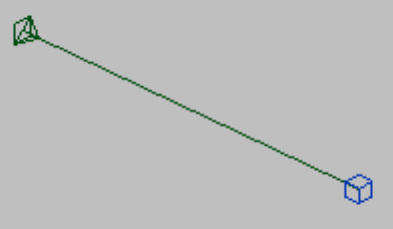
The same setting applies to all spinner fields. Since spinner snap is a toggle,
you can easily turn it on when needed and use the default at other times.
Spinner snap has no effect on dragging a spinner, only on single clicks.
For more information, see Spinner Snap on page 2572 .
Measuring Distances
3ds Max provides several options for measuring various aspects of your scene.
The tape, protractor and compass helpers measure distance, angles and
direction respectively. The Measure utility has a floater to display various
measurements of any selected object.
You can quickly measure the distance between two points with the Measure
Distance tool on page 2529 .
Helper Objects for Measurement
Tape Helper
You can create a Tape helper on page 2546 by dragging between any two points
in 3D space, much like using a physical tape measure. You then read the length
on the Parameters rollout.
If you turn on Specify Length, the length field lets you enter a value in current
units. This is like locking a tape measure to a set length. You can position the
tape object and snap to its ends.
The pyramid icon is the tape helper object; the cube is the helper object's target.
■To display length and angle settings, select only the tape helper object
(the pyramid icon).
2526 | Chapter 11 Precision and Drawing Aids
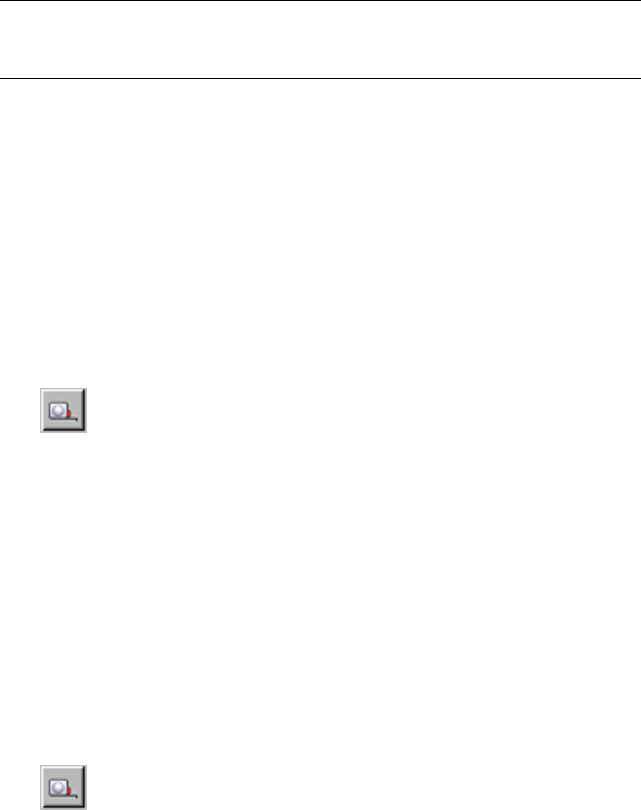
■To move the entire tape including its target (the cube icon), select the
connecting line.
Two sets of World Space Angles give you current readouts to the three world
axes (X, Y, Z) and the three world planes (XY, YZ, ZX).
TIP When measuring with precision, it is helpful to use snaps to force the ends of
the tape object to exact locations. If there are no specific points to snap to, you
can use dummy or point helpers to set points.
To measure with a tape helper using snaps:
1Locate points in the scene to which you can snap to accurately make a
measurement. If no points like this exist, create point objects on page
2544 at measurement extremes.
2Choose 3D from the Snap Toggle flyout.
3Right-click the Snap Toggle button to display the Grid and Snap Settings
dialog. On the Snaps tab, set the snap type to the type you will use for
measurement. For example, if you are going to use point objects for
measurement, check the Pivot option so you can snap to the point objects'
pivot points. Close the dialog.
4 On the Create panel, click the Helpers button, then click Tape.
Move the cursor over the first measurement point until the snap cursor
appears, then click and drag to the other measurement point.
5Read the length of the tape on the Parameters rollout.
Protractor
The Protractor helper on page 2549 measures the angle between pivot points
of two objects and the protractor object.
As with the tape helper, point objects and snap tools can be used to aid in
precise measurement of angles.
To measure an angle with a protractor:
1 On the Create panel, click the Helpers button, then click Protractor.
Click in a viewport to place the protractor object.
Measuring Distances | 2527
2On the Parameters rollout, click Pick Object 1 and select an object in your
scene. The name of the selected object appears above the pick button. A
line connects the protractor to the center of the object.
3Click Pick Object 2 and pick a second object. The angle between the
protractor and the two objects appears on the rollout.
4To move either object while watching the Angle readout, turn on the Pin
Stack button in the Modifier Stack rollout. This locks the stack to the
Protractor's Parameters rollout.
Compass
The Compass helper on page 2551 establishes an orientation for your scene.
You create this object with a single click and drag to define the radius, usually
in a Perspective or Top view. On its parameters rollout, you can adjust the
apparent radius of the compass rose. Like all helper objects, this object is for
reference only and does not render.
Measure Utility
The Measure Utility on page 2597 provides measurements of a selected object
or shape.
To use the Measure utility:
1On the Utilities panel, click Measure to display the Measure rollout.
2Select any shape or object and read out the measurements. If you select
multiple objects, the sum of the measurements is displayed.
3Click New Floater to display a modeless Measure dialog with all the same
information.
4Use the Measure dialog to display the length of a spline, like a line or
circle, as you create it.
Measure Distance Tool
The Measure Distance tool quickly calculates the distance between two points.
To measure the distance between two points:
1Choose Tools menu > Measure Distance
2Click in the viewport where you want to start measuring.
2528 | Chapter 11 Precision and Drawing Aids
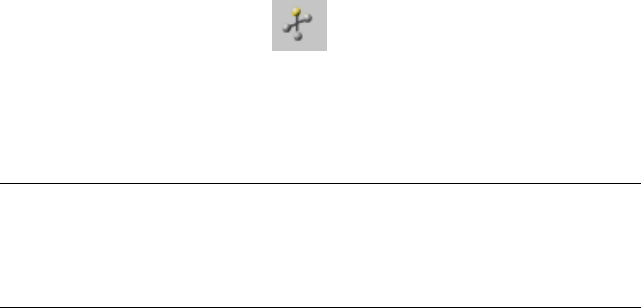
3Click in the viewport where you want to measure to.
A distance is returned in the Mini Listener. Additional information,
detailing the distance along the X, Y, and Z coordinates is displayed in
the status bar.
Measure Distance Tool
Tools menu > Measure Distance
The Measure Distance tool lets you quickly calculate the distance between
two points, using just two clicks. The calculated distance is displayed in display
units on page 7601 in the status bar.
Procedures
To measure the distance between two points:
1Choose Tools menu > Measure Distance.
2Click in the viewport where you want to start measuring from.
3Click again in the viewport where you want to measure to.
A distance is returned in the status bar. Additional information, detailing
the distance along the X, Y, and Z coordinates is displayed as well.
Select And Manipulate
Main Toolbar > Select And Manipulate button
The Select And Manipulate tool lets you edit the parameters of certain objects,
modifiers, and controllers by dragging "manipulators" in viewports.
NOTE Unlike Select And Move and the other transforms, this button's state is
non-exclusive. As long as Select mode or one of the transform modes is active,
and Select And Manipulate is turned on, you can manipulate objects. However,
you must turn off Select And Manipulate before you can select a manipulator
helper.
You can add these custom manipulators to your scene:
Measure Distance Tool | 2529
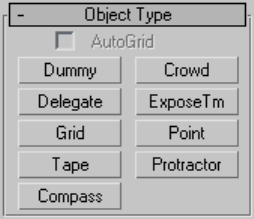
Cone Angle Manipulator on page 2552
Plane Angle Manipulator on page 2556
Slider Manipulator on page 2559
These features have manipulators built in, which you can use to change
parameters on these objects:
IK Solver Properties Rollout (HI Solver) on page 3336
Reaction Controllers on page 3147
Target Spotlight on page 4927
Target Directional Light on page 4932
mr Area Spotlight on page 4948
Free Spotlight on page 4930
Spotlight Parameters on page 5051
UVW Map Modifier on page 1849
Primitives on page 345 with a Radius parameter have a built-in manipulator
for the radius.
Standard Helper Objects
Create panel > Helpers > Standard > Object Type rollout
Create menu > Helpers
The standard set of helper objects includes the following:
Dummy Helper on page 2531
Crowd Helper on page 4738
2530 | Chapter 11 Precision and Drawing Aids
Delegate Helper on page 4730
Expose Transform Helper on page 2532
Grid Helper on page 2538
Point Helper on page 2544
Tape Helper on page 2546
Protractor Helper on page 2549
Compass Helper on page 2551
See also:
■Atmospheric Apparatus on page 6560
■Camera Helper on page 5157
■Assembly Heads Helper on page 235
■Manipulator Helper Objects on page 2552
■Particle Flow helpers: SpeedByIcon on page 2796 and Find Target on page
2891
■VRML97 Helper Objects on page 7093
■reactor Helpers on page 3830
Dummy Helper
Create panel > Helpers > Standard > Object Type rollout > Dummy
Create menu > Helpers > Dummy
A Dummy helper object is a wireframe cube with a pivot point at its geometric
center. It has a name but no parameters, you can't modify it, and it doesn't
render. Its only real feature is its pivot, used as a center for transforms. The
wireframe acts as a reference for transform effects.
The dummy object is used primarily in hierarchical linkages. For example,
you can use a dummy object as a center of rotation by linking a number of
different objects to it. When you rotate the dummy, all of its linked children
rotate with it. A dummy is often used this way to animate linked motion.
Dummy Helper | 2531
Another common usage of a dummy object is in the animation of target
cameras. You can create a dummy and position a target camera within the
dummy object. Then you can link both the camera and its target to the
dummy, and animate the dummy with a path constraint. The target camera
will follow the dummy along the path.
Dummy objects are always created as cubes. You can change the proportions
of dummies by using non-uniform scaling, but avoid this on dummies that
are within a hierarchical linkage; this can introduce unexpected results.
Procedures
To create a dummy object:
■Click Dummy and drag a cube to any convenient size.
Interface
Dummy objects don't have any parameter rollouts or settings.
Expose Transform Helper
Create panel > Helpers > Standard > Object Type rollout > ExposeTm
Create menu > Helpers > Standard > ExposeTm
The Expose Transform helper exposes values of non-keyed objects for use in
expressions and scripts. This lets riggers and animators access a select set of
transforms for an object, and between an object and its parent, such as a bone
in an IK chain. For example, using the Expose Transform helper, you could
write a script or use parameter wiring that tests the angle of an character's arm
bone that's controlled by IK (thus, has no keys), and once it exceeds a specific
value, rotate the corresponding clavicle bone to deform the shoulder area.
In the viewports, the Expose Transform helper object looks just like a Point
helper on page 2544 .
Procedures
To use the Transform helper:
1Click ExposeTm and choose the appearance characteristics from the
Display rollout.
2532 | Chapter 11 Precision and Drawing Aids
2Adjust the size of the helper object by using the Size spinner on the
Display rollout. Default=20.0
3Click anywhere in your scene to add the helper object.
The helper object's position has no bearing on its functionality.
4On the Modify panel > Parameters rollout, click the Expose Node button
(default label: None) and select the object whose transform values you
want to expose.
The object's name appears on the button, and its transform values appear
in the fields on the Expose Values rollout.
5Optionally, turn off Parent and choose a Local Reference Node object.
This option is used by the Local Euler Angles, Distance To Reference, and
Angle parameters. If the object has no parent and you don't specify a
Local Reference Node object, these fields use the world center (0,0,0) as
the reference node.
6To use a transform value in a script or expression, first click the M button
next to the parameter value.
This copies the transform name, using MAXScript notation, to the copy
buffer.
7Paste the contents of the buffer to your script or expression.
A sample result of this is “$ExposeTransform01.localPositionX”. 3ds Max
interprets this as the local position, on the X axis, of the Expose Node
object.
Expose Transform Helper | 2533
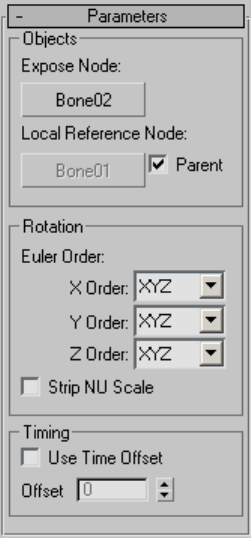
Interface
Parameters rollout
These settings let you specify the exposed node, a reference object other than
the parent, and rotation and timing parameters.
Expose Node The object from which the values are generated. Click the
button, and then select the object. Thereafter, the object name appears on
the button.
Local Reference Node The object whose relationship with the Expose Node
object is used to generate local data for rotation, distance, and angle. Click
the button, and then select the object. Available only when Parent is off.
By default, this is the parent object, but you can turn off Parent and then
specify a different object.
Parent When on, the Local Reference Node is set automatically to the parent
of the Expose Node. When off, you can pick an object to refer to for local data.
Default=on.
2534 | Chapter 11 Precision and Drawing Aids
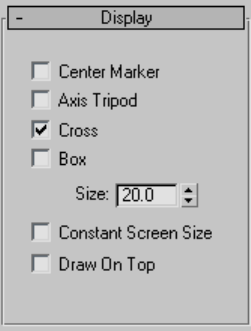
This is used by the Local Euler Angles, Distance To Reference, and Angle
parameters. If the object has no parent and you don't specify a Local Reference
Node object, these fields use the world center (0,0,0) as the reference node.
Rotation Order These three settings determine the order in which the Expose
Transform helper will look for an Euler rotation.
This parameter corrects for anomalies that can be introduced when a local
rotation value is generated in relation to other rotation values. For example,
when Z Order is set to XYZ, the Z value is generated in reference to X and
then Y. Or when X Order is set to ZXY, the Z value is generated directly in
reference to the parent, regardless of X and Y rotations.
Strip NU Scale When on, removes any non-uniform scaling that could
influence the rotation data. It does not strip non-uniform scaling from the
object; only from the values generated.
Use Time Offset When on, lets you specify a frame other than the current
one from which to gather data. The Offset value is added to the current frame
to derive the frame from which data is gathered.
For example, if the current frame is 20 and you wish to gather data from frame
15, turn on Use Time Offset and set Offset to -5.
Display rollout
Lets you specify how the helper object appears in the viewports. By default,
the display type is set to Cross only, and Size is set to 20.0. You can activate
multiple display settings if you like.
Center Marker Displays a small X marker at the center of the helper object.
Expose Transform Helper | 2535
Axis Tripod Displays a tripod axis indicating the position and orientation
of the helper object.
Cross Displays an axis-aligned cross.
Box Displays a small axis-aligned box at the center of the helper object.
Size Sets the size for the helper object. Use this setting to minimize the
helper object, or increase its size to aid in locating it. Default=20.0.
Constant Screen Size Keeps the size of the helper object constant, regardless
of how much you zoom in or out.
Draw On Top Displays the helper object on top (or in front) of all other
objects in the scene.
2536 | Chapter 11 Precision and Drawing Aids

Exposed Values rollout
Expose Transform Helper | 2537
This rollout provides readouts of values for all transform values of the Expose
Node object. Each value has a button labeled “M” next to it; click this button
to copy the MAXScript associated with the value to the clipboard, which you
can then paste into a script.
Display Exposed Values When on, transform values for the Expose Node
object appear on this rollout, and update as the values change. When off,
values don't appear, but the M buttons still function normally.
Local Euler Angles Rotation values with respect to the parent or Local
Reference Node object.
World Euler Angles Rotation values in the world coordinate system.
Local Position Position values with respect to the Expose Node object's local
coordinate system.
World Position Position values in the world coordinate system.
Bounding Box The maximum dimensions of the object.
Distance to Reference The distance between the Expose Node object and its
parent or the designated Local Reference Node object. If neither exists, this
shows the distance to the world center (0,0,0).
Angle The angle between the Expose Node object and its parent or the
designated Local Reference Node object.
Grid Helper
Create panel > Helpers > Standard > Object Type rollout > Grid
Create menu > Helpers > Grid
The grid, also called User Grid or Custom Grid, is a 2D parametric object with
adjustments for overall size and grid spacing. You can move and orient user
grids anywhere in world space.
You can create any number of grid objects in your scene. You name them
when you create them and save them with the scene. You can delete them at
any time.
Like other objects you create in the software, grid objects are placed on the
grid of the current viewport. By default, this is a plane of the home grid, but
it can also be another activated grid object.
2538 | Chapter 11 Precision and Drawing Aids

NOTE You can use AutoGrid on page 2513 to create a temporary or permanent
user grid off the surface of any object.
Using the Grid Object
You can use the grid object as a construction plane on all three orthographic
planes in both directions. Here's how it works:
In the Parameters rollout of each grid object is a Display group with three
options: XY Plane, YZ Plane, and ZX Plane. These determine which of the
three planes of the grid object is displayed in the viewport.
When you activate a grid object, the displayed plane is the construction plane
for all viewports. When you create a grid viewport, you can choose from one
of six orthographic views (Front, Top, Left, and so on), or you can choose a
special Display Planes grid viewport. (When you press the G key to create a
grid viewport, the Display Planes type becomes the default.) The Display Planes
type of grid viewport always displays the plane chosen by the three option
buttons under Display. Thus, as you switch between XY Plane, YZ Plane, and
ZX Plane, the view through the grid viewport switches accordingly, and objects
created in that viewport are created on the displayed plane.
When you right-click a viewport label (or go to the Layout tab of the Viewport
Configuration dialog), you can choose six additional types of grid viewports,
based on the six orthographic views. These are available by a cascading Grid
menu that provides Left, Right, Front, Back, Top, Bottom, and Display Planes.
Each of the orthographic directions is local to the grid object, regardless of its
orientation in the scene.
When you choose a specific orthographic grid viewport (as opposed to the
Display Planes viewport), the construction of objects in that viewport is on
the plane specified in the viewport title regardless of the displayed plane of
the grid object.
You can create more than one viewport based on the same grid object, with
each using a different plane. For example, you can have a Grid (Front) viewport
and a Grid (Top) viewport, as well as a Grid (Display Planes) viewport.
When you deactivate a grid object, its remaining viewports show the assigned
orthographic view. Thus, a Grid (Front) viewport becomes a Front viewport,
for example. A Grid (Display Planes) viewport always reverts to a Top view,
regardless of the currently displayed plane.
Grid Helper | 2539

Scaling Not Advised
As a rule, don't use scaling to resize a grid object. Scaling enlarges or reduces
the apparent size of the grid object but has no effect on grid spacing. A sphere
20 units in radius created on a grid object appears smaller than another 20-unit
sphere created on a scaled-up version of the same grid.
If you want to change the actual size of the grid object, select it and go to the
Modify panel > Parameters rollout > Grid Size group, and change the Length
and Width settings.
Locating Grid Tools
Grid tools are spread throughout the 3ds Max interface.
■In the Views menu, under Grids, are the commands to activate home and
user grids.
The same tools are available with a right-click anywhere in the viewport
when a grid helper is selected.
■Right-click anywhere in the viewport while a grid object is selected and
the Tools1 quadrant of the quad menu provides commands to activate the
home and user grids.
■Choose Customize menu > Grid and Snap Settings to display the Grid and
Snap Settings dialog on page 2577 . Two tabs are devoted to Grid tools, one
for home, another for user grids. You can change parameters of any active
grid using the Modify panel.
See also:
■Viewing Grid Objects on page 2511
Procedures
To create a grid object:
1Do one of the following:
■ Click Create panel > Helpers > Standard > Object Type rollout
> Grid.
■Choose Create menu > Helpers > Grid.
The Parameters rollout appears on the Create panel.
2540 | Chapter 11 Precision and Drawing Aids
2In a viewport, drag out a rectangle and release the mouse button. This
creates and selects a grid object, which appears in white wireframe, divided
into four quadrants with coordinate axes at the center.
While the newly created grid object is still selected, you can change its settings
on the Parameters rollout.
You can also create a grid object during object creation. Turn on AutoGrid,
then press Alt during object creation. A grid is created at the same time as the
object and remains displayed and active. See AutoGrid on page 2513 for more
information.
To activate a grid object:
A grid object requires activation before use. Standard selection doesn't activate
it unless you turn on the option to do so (see User Grids on page 2595 ).
Only one grid can be active for construction at a time, whether it's the home
grid or a grid object. Activating a user grid "deactivates" the home grid.
Activating a grid object enables options to reactivate the home grid on the
Views menu > Grids submenu and the Quad menu.
If you have more than one grid object in your scene, you have to activate each
one separately. Select the grid object you want to make active and follow the
same procedure. Activating another grid object deactivates the current one.
1Select a grid object.
2Do one of the following:
■From the Views menu, choose Grids > Activate Grid Object.
■Right-click the selected grid object and choose Activate Grid from the
quad menu.
The grid object changes to show its internal grid structure. Except for its
main axes, the home grid disappears in all viewports.
To reactivate the home grid, do one of the following:
1From the Views menu, choose Grids > Activate Home Grid.
2Right-click the selected grid object and choose Activate Home Grid from
the quad menu.
This deactivates the grid object and returns the home grid in all views.
If you delete an activated grid object, the home grid also reactivates.
Grid Helper | 2541
You can assign a keyboard shortcut to Activate Home Grid in the
Keyboard panel on page 7489 of the Customize User Interface dialog. This
is useful if you need to move back and forth between different grids.
To use a grid object as construction plane:
When activated, a grid object replaces the home grid as the frame of reference
for creating objects.
An activated grid object creates a true plane in 3D space. No matter how small
an activated grid object appears on screen, its XY plane is effectively infinite,
just as if it were the XY plane of the home grid.
1Activate the grid object.
2Create any category of object.
3ds Max creates the object directly on the plane of the grid object, with
the object's Z axis perpendicular to the plane.
3Use File menu > Merge to import an object.
3ds Max creates the object directly on the plane of the grid object, with
the object's Z axis perpendicular to the plane.
See Align on page 938 for details on aligning objects and grids.
Like other objects in the software, you can move and rotate grid objects freely
using standard transformation methods. These transforms, along with
alignment, are essential in positioning a construction plane in 3D space.
To nudge a grid object up or down:
1Activate the grid object.
2Press the + or − keys on the numeric keypad to move the grid object up
or down.
The Grid Nudge Distance is controlled in the Viewports panel on page
7545 of the Preferences dialog.
2542 | Chapter 11 Precision and Drawing Aids
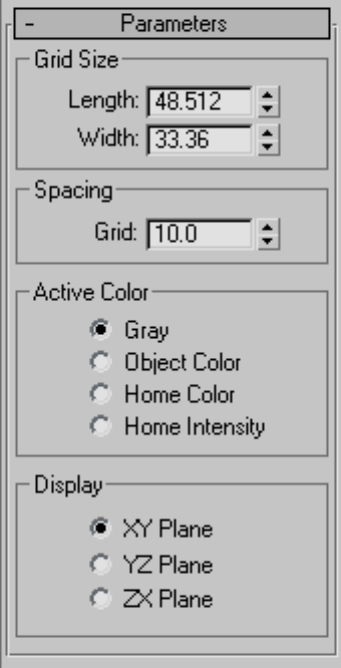
Interface
Grid Size group
Sets the overall size of the grid object. This size determines the extents of a
viewport set to the grid object. It doesn't affect the useful limits of the grid,
which extend infinitely.
Length/Width Specifies the length and width of the grid.
Grid Spacing group
Grid Specifies the size of the smallest square in the visible grid. This setting
appears on the status line when the grid is activated.
Grid Helper | 2543

NOTE You can set Grid Spacing when a grid is selected, but you won't see the
grid spacing until the grid is activated.
Active Color group
Determines the color used to draw the grid in viewports when it's not selected.
Gray The active grid object is two shades of gray.
Object Color The main grid lines use the assigned object color, while the
secondary lines use a lighter intensity.
Home Color The grid object uses the home grid color assigned via the
Customize User Interface dialog on page 7489 .
Home Intensity The grid object uses the grid intensity settings assigned to
the home grid in the Customize User Interface dialog on page 7489 .
Display group
XY Plane, YZ Plane, ZX Plane Determines which of the three planes of the
grid object are displayed in the viewport.
Point Helper
Create panel > Helpers > Standard > Object Type rollout > Point
Create menu > Helpers > Point
Point provides a specific location in 3D space that can be used as a reference
or by other program functions.
Procedures
To create a point in space:
1Click Point and check the type of display from the Parameters rollout.
2Adjust the size of the point object by using the Size spinner in the
Parameters rollout. Default=20.0
3Left-click and drag anywhere in your scene.
The point follows the cursor until you release the mouse button,
indicating the current location of the point object.
2544 | Chapter 11 Precision and Drawing Aids
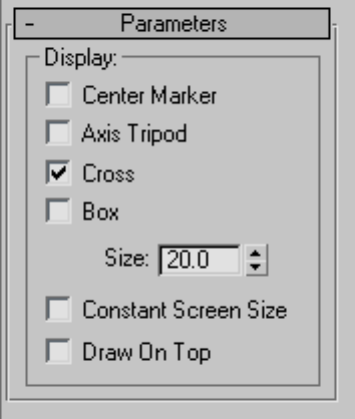
4Move the cursor to where you want the point object and release the
mouse button.
The point object appears using the display setting you chose.
You can move and rotate the point as needed using standard
transformation methods.
Interface
Center Marker Displays a small X marker at the center of the point object.
Axis Tripod Displays a tripod axis indicating the position and orientation
of the point object. The axis remains visible when the point object is no longer
selected.
Cross Displays an axis-aligned cross.
Box Displays a small axis-aligned box at the center of the point object.
Size Sets the size for the point object. Use this to minimize the point object,
or increase its size to aid in locating it. Default=20.
Constant Screen Size Keeps the size of the point object constant, regardless
of how much you zoom in or out.
Draw On Top Displays the point object on top of all other objects in the
scene.
Point Helper | 2545
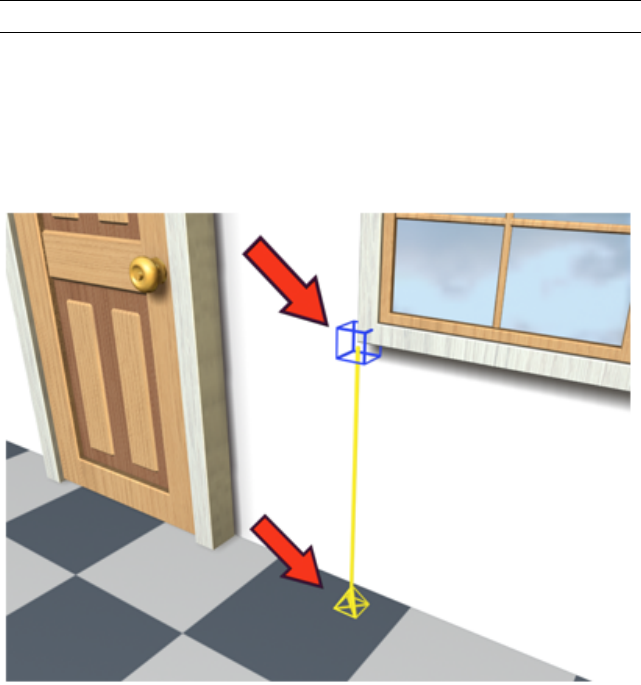
NOTE You can also choose to activate multiple display settings.
Tape Helper
Create panel > Helpers > Standard > Object Type rollout > Tape
Create menu > Helpers > Tape Measure
Using a tape helper to measure the distance from floor to window frame.
Tape provides an on-screen "tape measure" for determining and setting
distances. The tape is composed of two named objects, in the same way targeted
lights and cameras are. By default, these are named Tape## and Tape##.Target.
The tape and target icons are connected by a line representing the current
distance between them.
You can drag a length (the default), or enter a specific length by turning on
Specify Length. You can snap or align either end of the tape or link to objects
in your scene. Deleting either end deletes the tape.
2546 | Chapter 11 Precision and Drawing Aids
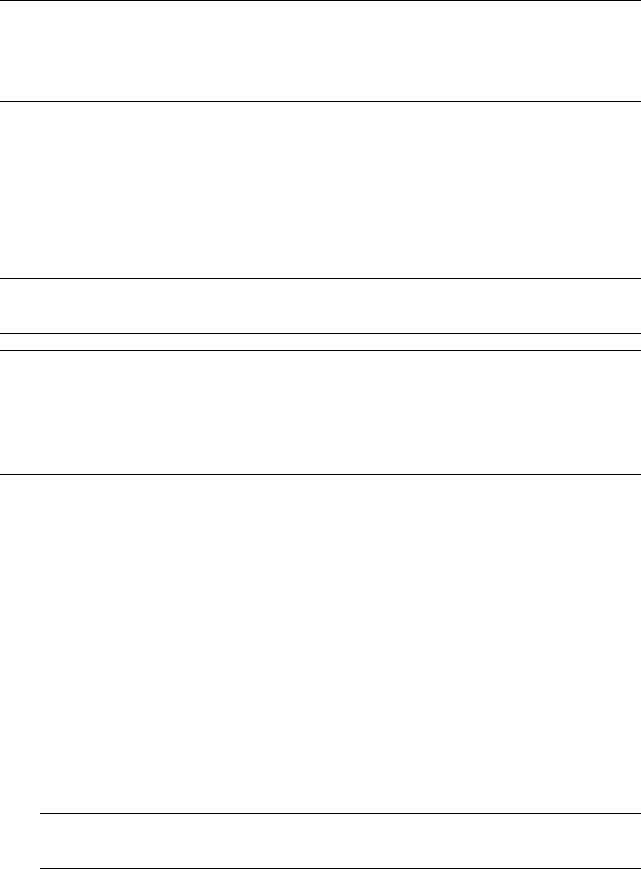
NOTE When you add a Tape helper object, the software automatically assigns a
Look At controller on page 3124 to it, with the tape's target object assigned as the
Look At target. You can use the controller settings on the Motion panel to assign
any other object in the scene as the Look At target.
Selection
You can select a tape-measure object from either end, or from the middle.
When you click the connecting line, both ends of the tape object become
selected so you can move them as one. Note that the same is true of target
cameras and lights.
NOTE Line selection is available only when clicking with the mouse. Region
selection doesn't work for this.
TIP The Length readout of the tape object is displayed in the Modify panel only
when you select the tape end of the object (as opposed to the target or link line).
You can lock the Length display by activating the Pin Stack button while the tape
end is selected, and then proceed to adjust any part of the tape object or any
other object in your scene.
See also:
■Measure Distance Tool on page 2529
Procedures
To measure a distance:
1Click Tape and drag from one point to create the tape, and then drag to
a second point and release the mouse button to create the target.
The distance between tape and target appears in the Length field. The
number in the Length field is gray to indicate that this is a read-only
measurement.
NOTE To snap the tape ends to object vertices, edges and so on, turn on
Snap on page 2568 with the appropriate snap settings activated.
2Move either end to a new location. The line between stretches to the new
distance, shown in the Length field.
Tape Helper | 2547
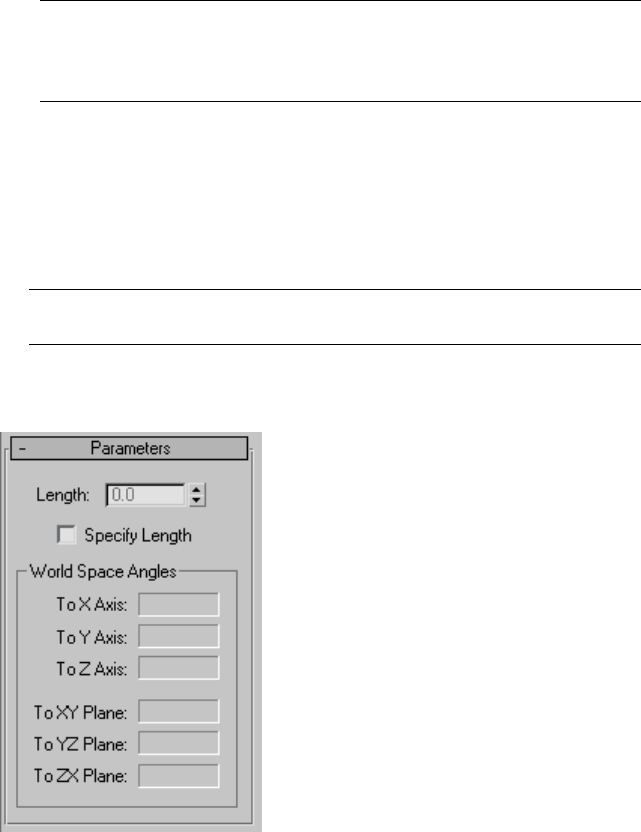
NOTE For accurate results when moving a tape endpoint with Snap, you
must turn on Pivot in the Snap Settings panel as well as the types of sub-object
you want to snap to; see Snaps on page 2578 . This is because the endpoints
are actually pivots.
To set a distance:
■Turn on Specify Length in the Parameters rollout, enter a length, and then
create the tape.
The connector line is the length you specified, although you can still set
the target to any offset by dragging. You can reorient this line as required.
NOTE Clearing Specify Length will adjust the connector line length to meet
the target and the new length appears in the Length field.
Interface
Parameters rollout
Length Specifies the length of the tape object. You must select the Specify
Length check box to enable this option.
2548 | Chapter 11 Precision and Drawing Aids
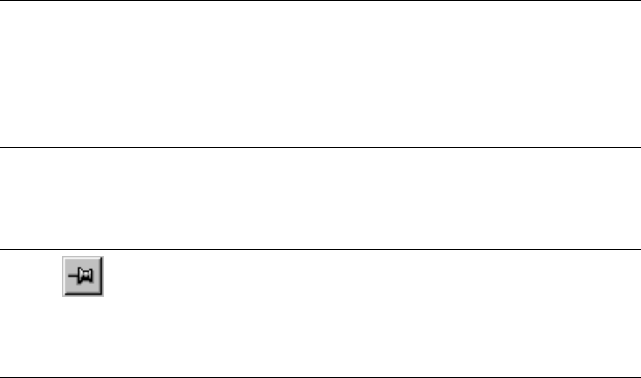
Specify Length Activates the Length parameter setting. Otherwise the tape
object's length will be specified by clicking and dragging in the viewport.
World Space Angles group
To X/Y/Z Axis Displays the angle of the tape object relative to each axis in
world space.
To XY/YZ/ZX Plane Displays the angle of the tape object relative to each of
these home planes.
Protractor Helper
Create panel > Helpers > Standard > Object Type rollout > Protractor
Create menu > Helpers > Protractor
Protractor measures the angle between a point and any two objects in your
scene.
The names of the two objects appear above their respective buttons, and the
angle formed at the protractor object between the pivot points of the two
objects is displayed in the Angle field. Lines are drawn between the protractor
and the two selected objects.
NOTE The line to the first selected object uses the Target Line color, and the line
for the second selected object uses the color of the protractor. The Target Line
color is set with Customize User Interface dialog > Colors panel on page 7505 >
Elements drop-down list > Gizmos group. The Protractor color is set by choosing
the Tape Object in Customize User Interface dialog > Colors panel on page 7505
> Elements drop-down list > Objects group.
You can reselect the protractor at any time, enter the Modify panel on page
7425 , and pick new objects to measure. You can move either of the two objects
or the protractor itself to change the angle.
NOTE If you need to watch the Angle readout while moving either of the
objects, first select the protractor, then click the Pin Stack button on the Modify
panel. You can now select and move the other objects while the stack remains
pinned to display the protractor angle.
Protractor Helper | 2549
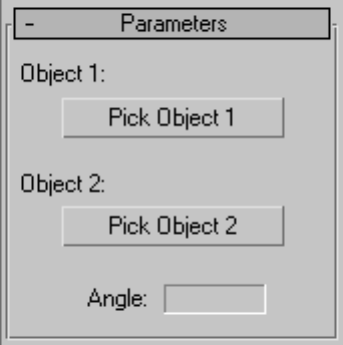
Procedures
To use the protractor:
1After selecting Protractor in the Create panel > Helpers section, click in
the viewport to place and create the protractor icon. You can also drag
to move it before releasing the mouse button.
2Click the Pick Object 1 button, and then select one of the objects in the
scene.
The name of the selected object appears above the button.
3Click Pick Object 2, and then select a second object in the scene.
The Angle parameter shows the angle formed by lines from the protractor
object to the two picked objects.
Interface
Parameters rollout
Pick Object 1 Click this and select the first of the two objects whose angle
you want to measure.
Pick Object 2 Click this and select the second of the two objects whose angle
you want to measure.
Angle Displays the angle formed by the lines from the protractor to the two
objects.
2550 | Chapter 11 Precision and Drawing Aids
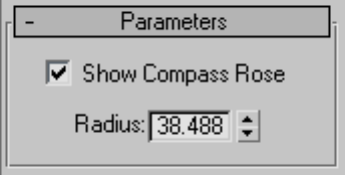
Compass Helper
Create panel > Helpers > Standard > Object Type rollout > Compass
Create menu > Helpers > Compass
Compass displays as a non-rendering compass rose, with indicators for North,
South, East, and West. A compass is part of a Daylight or Sunlight system on
page 5024 ; you create a compass automatically when you create sunlight. In a
Sunlight system, the orientation of the compass indicates the orientation of
the scene, relative to the path of the sun (the ecliptic).
Use the Compass helper object if you want to create an orientation symbol
in your scene, but don’t need to create a sunlight system.
Procedures
To create a compass object:
1Choose Compass in the Create panel > Helpers section.
2Click and drag to define the radius of the compass.
3Select and rotate the compass object to orient it.
Interface
Parameters rollout
Show Compass Rose Displays the non-rendering compass rose in the
viewport.
Radius Specifies the radius of the compass object.
Compass Helper | 2551
Manipulator Helper Objects
Create panel > Helpers > Manipulators > Object Type rollout
Create menu > Helpers > Manipulators
Manipulator helpers are objects you can create to manipulate other objects.
They let you add customized controls to your scene that provide visual
feedback in viewports. To control other objects, manipulators use the
parameter wiring feature on page 3247 .
Manipulators can be especially useful when you create a scene that will be
used by more than one animator.
There are three kinds of manipulator helpers:
Cone Angle Manipulator on page 2552
Plane Angle Manipulator on page 2556
Slider Manipulator on page 2559
See also:
■Wire Parameters on page 3247
■Parameter Wiring Dialog on page 3249
■Select And Manipulate on page 2529
Cone Angle Manipulator
Create panel > Helpers > Manipulators > Object Type rollout > Cone Angle
button
Create menu > Helpers > Manipulators > Cone Angle
The Cone Angle manipulator is a cone whose base you can adjust. By wiring
its Angle value to a parameter of another object, you can create a custom
control, with visual feedback, within a scene.
2552 | Chapter 11 Precision and Drawing Aids
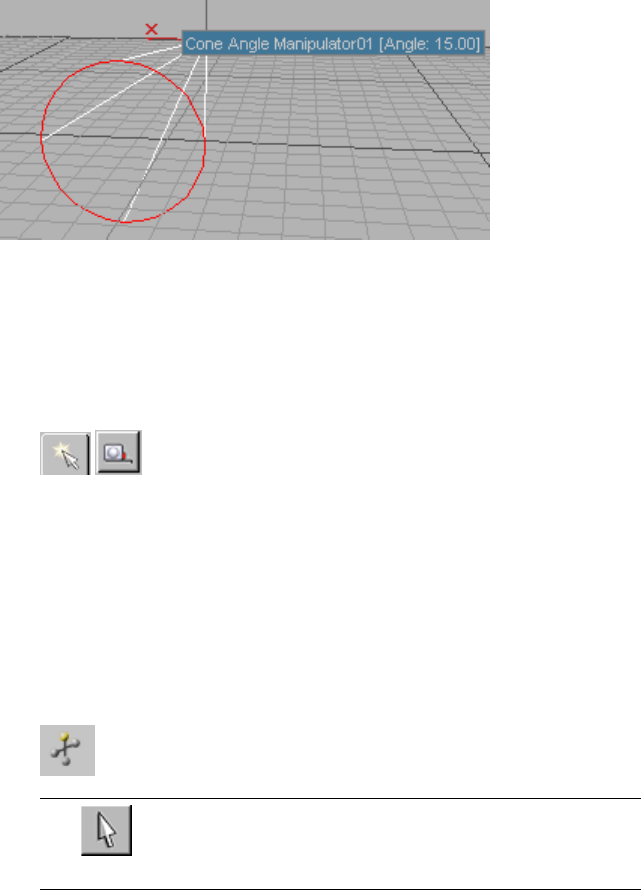
Cone angle manipulator
Cone angle manipulators are used by a spotlight's Hotspot and Falloff controls.
Procedures
To create a cone angle manipulator:
1 In the Create panel, go to Helpers and choose Manipulators
from the drop-down list.
2Click to turn on Cone Angle.
3Drag in a viewport, and then release the mouse.
The cone angle manipulator is created along the negative Z axis of the
viewport in which you drag. In other words, its initial position points
away from you.
To change the angle of a cone angle manipulator:
1 Turn on Select And Manipulate.
TIP If you are still in the Create panel, turn on Select Object before
using the manipulator. Otherwise, it is too easy to create a new one.
2In a viewport, move the mouse over the manipulator.
Cone Angle Manipulator | 2553
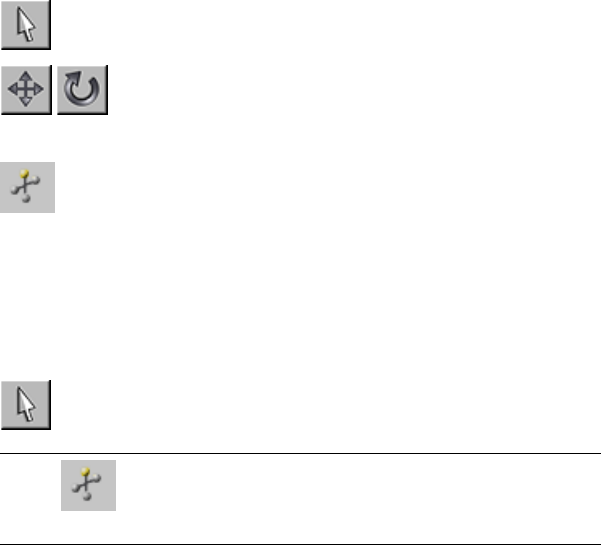
The manipulator turns red when the mouse is over it and it is available
to be manipulated. Also, a tooltip appears, showing the name of the
manipulator and its current value.
3Drag the base of the cone angle manipulator's cone.
The Angle value changes as you drag the manipulator. This value can
range between 0.0 and 180.0.
To select a cone angle manipulator:
1 Turn on Select Object.
You can also use Select And Move, Select And Rotate, and
the scale options on a cone angle manipulator.
2 Turn off Select And Manipulate.
If you don't turn off Select And Manipulate, you adjust the manipulator's
Angle value without affecting its properties.
3Adjust the properties of the selected manipulator.
To connect a cone angle manipulator so it controls another object:
1 Select the cone angle manipulator.
NOTE Select And Manipulate must be off before you can select the
manipulator.
2Choose Animation > Wire Parameters > Wire Parameters.
You can also right-click the manipulator and choose Wire Parameters
from the Transform (lower-right) quadrant of the quad menu.
A pop-up menu appears over the manipulator.
3In the pop-up menu, choose Object (Cone Angle Manipulator) > Angle.
4Click the object you want to manipulate.
2554 | Chapter 11 Precision and Drawing Aids

A pop-up menu appears over the object.
5In the pop-up menu, choose Object, then the name of the parameter you
want to manipulate.
The Parameter Wiring dialog on page 3249 appears.
6On the Parameter Wiring dialog, click the “control direction” arrow
between the two upper lists that goes from the manipulator to the object
(or both directions), and then click Connect.
7Close the Parameter Wiring dialog.
Now when you turn on Select And Manipulate and use the manipulator,
the object updates under the manipulator's control.
Interface
Angle The initial angle of the manipulator.
Distance The length of the manipulator, in 3ds Max units. Default=the
distance of mouse drag when the manipulator was created.
Use Square When on, the base of the cone is square or rectangular, rather
than circular. Default=off.
Aspect When Use Square is on, adjusts the aspect ratio of the rectangular
cone base. Default=1.0.
Cone Angle Manipulator | 2555
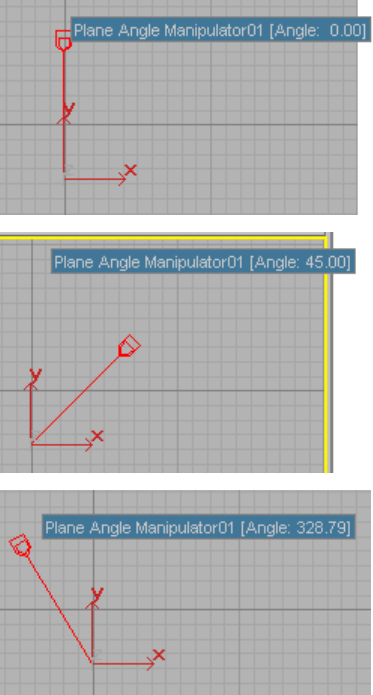
Plane Angle Manipulator
Create panel > Helpers > Manipulators > Object Type rollout > Plane Angle
button
Create menu > Helpers > Manipulators > Plane Angle
The Plane Angle manipulator looks like a lever or joystick. By wiring its Angle
value to a parameter of another object, you can create a custom control, with
visual feedback, within a scene.
Plane angle manipulator at different angles
2556 | Chapter 11 Precision and Drawing Aids
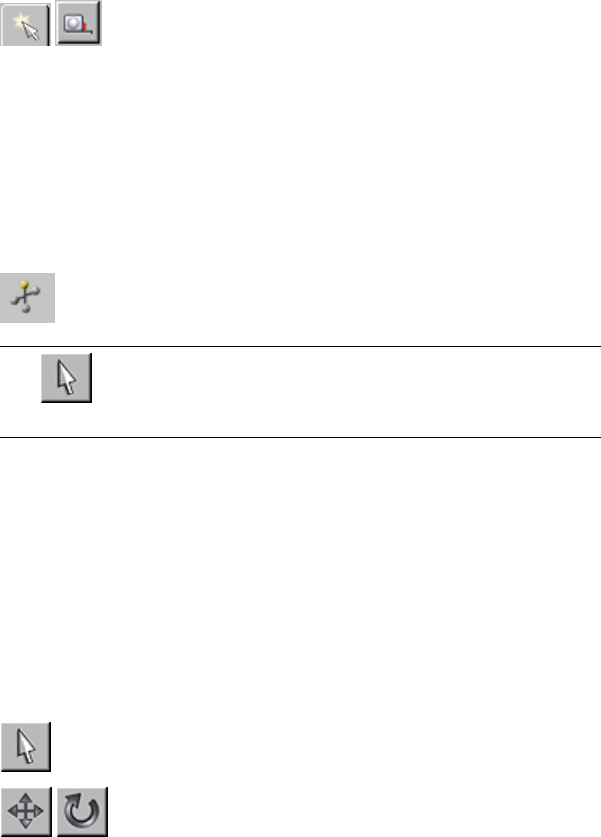
Procedures
To create a plane angle manipulator:
1 In the Create panel, go to Helpers and choose Manipulators
from the drop-down list.
2Click to turn on Plane Angle.
3Drag in a viewport, and then release the mouse.
The plane angle manipulator is always created vertically, along the Y axis
of the viewport in which you drag.
To change the angle of a plane angle manipulator:
1 Turn on Select And Manipulate.
TIP If you are still in the Create panel, turn on Select Object before
using the manipulator. Otherwise, it is too easy to create a new one.
2In a viewport, move the mouse over the manipulator.
The manipulator turns red when the mouse is over it and it is available
to be manipulated. Also, a tooltip appears, showing the name of the
manipulator and its current value.
3Drag the handle of the plane angle manipulator.
The Angle value changes as you drag the manipulator. This value can
range between -100000.0 and 100000.0.
To select a plane angle manipulator:
1 Turn on Select Object.
You can also use Select And Move, Select And Rotate, and
the scale options on a plane angle manipulator.
Plane Angle Manipulator | 2557
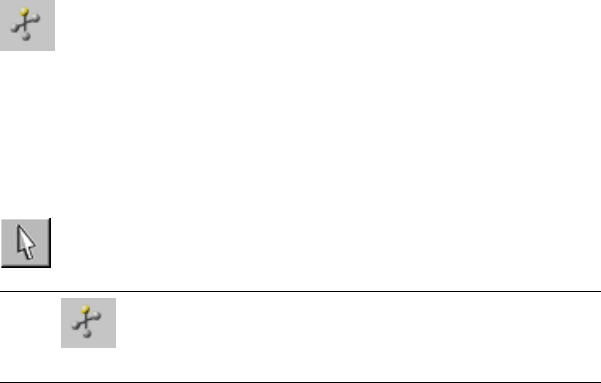
2 Turn off Select And Manipulate.
If you don't turn off Select And Manipulate, you adjust the manipulator's
Angle value without affecting its properties.
3Adjust the properties of the selected manipulator.
To connect a plane angle manipulator so it controls another object:
1 Select the plane angle manipulator.
NOTE Select And Manipulate must be off before you can select the
manipulator.
2Choose Animation > Wire Parameters > Wire Parameters.
You can also right-click the manipulator and choose Wire Parameters
from the Transform (lower-right) quadrant of the quad menu.
A pop-up menu appears over the manipulator.
3In the pop-up menu, choose Object (Plane Angle Manipulator) > Angle.
4Click the object you want to manipulate.
A pop-up menu appears over the object.
5In the pop-up menu, choose Object, then the name of the parameter you
want to manipulate.
The Parameter Wiring dialog on page 3249 appears.
6On the Parameter Wiring dialog, click the “control direction” arrow
between the two upper lists that goes from the manipulator to the object
(or both directions), and then click Connect.
7Close the Parameter Wiring dialog.
Now when you turn on Select And Manipulate and use the manipulator,
the object updates under the manipulator's control.
2558 | Chapter 11 Precision and Drawing Aids
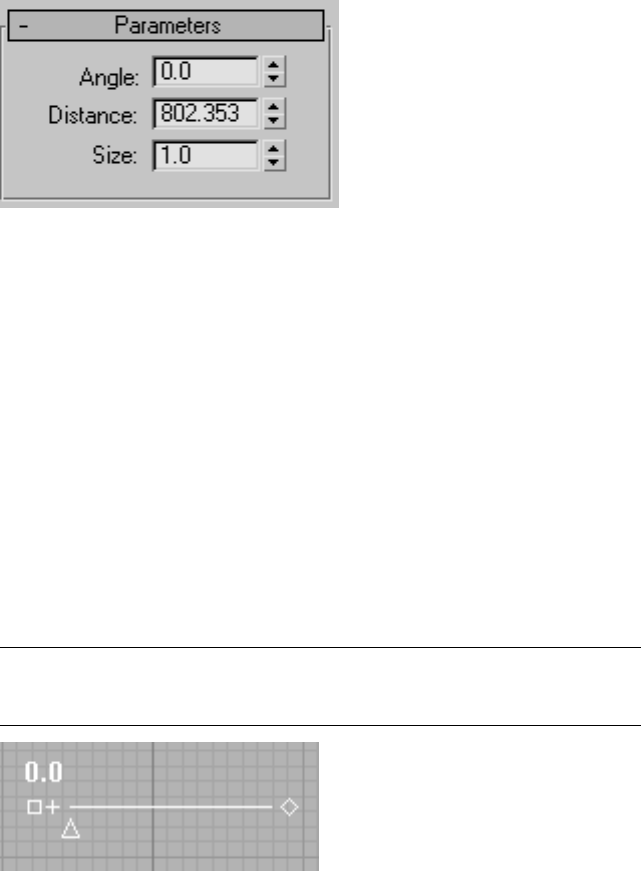
Interface
Angle The angle of the manipulator, from 0.0 to 360.0 (both values are
perpendicular in the Y axis of the viewport where you created the manipulator,
unless you have rotated the manipulator object). Default=0.0.
Distance The length of the manipulator, in 3ds Max units. Default=the
distance of mouse drag when the manipulator was created.
Size The size of the manipulator's handle, in 3ds Max units. Default=1.0.
Slider Manipulator
Create panel > Helpers > Manipulators > Object Type rollout > Slider button
Create menu > Helpers > Manipulators > Slider
The Slider manipulator is a graphic control that appears in the active viewport.
By wiring its Value to a parameter of another object, you can create a custom
control, with visual feedback, within a scene.
NOTE Because the slider manipulator is a custom control, its Value has no inherent
unit. It takes on the unit of the parameter to which it is wired. When the minimum
is 0.0 and the maximum is 100.0, the slider Value can represent a percentage.
Slider manipulator
Slider Manipulator | 2559
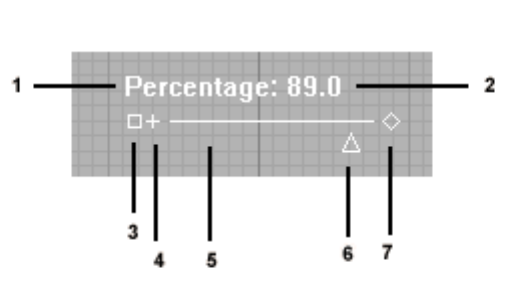
Using a Slider Manipulator
Slider manipulator components:
1. Label
2. Value
3. Move
4. Show/hide
5. Slider bar
6. Adjust value
7. Change width
The slider appears in the same location in whichever viewport is active.
You can adjust the slider's value by dragging the triangle below the slider bar.
The triangle turns red when you move the mouse over it. It represents the
slider's value, and the value changes as the triangle is dragged. You can also
make the following changes without going into the Modify panel:
■Dragging the small square at the left moves the slider.
■Dragging the diamond at the right changes the width of the slider.
■Clicking the plus sign (next to the move icon at the left) hides all of the
slider except for the label and the move icon.
Like the Value triangle, these components also turn red when you move the
mouse over them.
2560 | Chapter 11 Precision and Drawing Aids
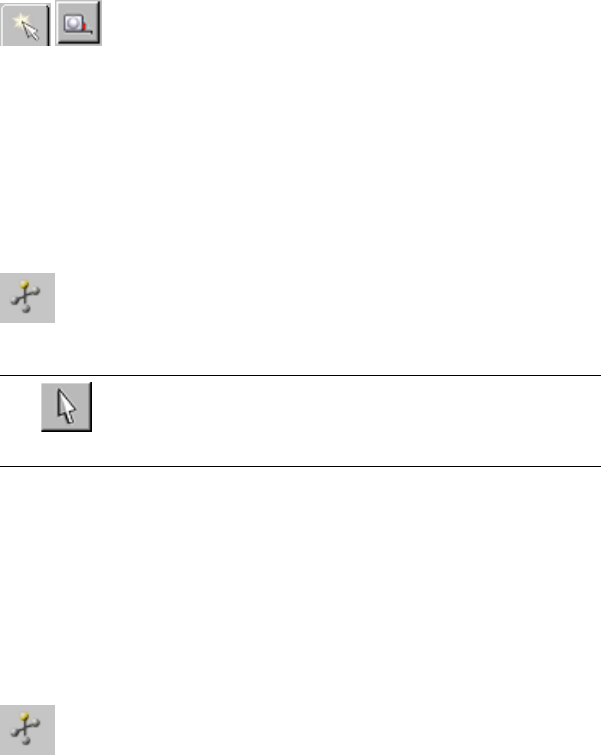
Procedures
To create a slider manipulator:
1 In the Create panel, go to Helpers and choose Manipulators
from the drop-down list.
2Click to turn on Slider.
3Click a viewport.
The slider manipulator is created with its default width of 100 units. It
will appear at the same viewport location in whichever viewport is active.
To change the value of a slider manipulator:
1 Turn on Select And Manipulate.
The slider turns green.
TIP If you are still in the Create panel, turn on Select Object before
using the manipulator. Otherwise, it is too easy to create a new one.
2In a viewport, move the mouse over the triangle below the slider bar.
The triangle turns red when the mouse is over it and it is available to be
dragged.
3Drag the value triangle of the slider manipulator.
The slider's value display changes as you drag the triangle.
To move a slider manipulator:
1 Turn on Select And Manipulate.
2In the active viewport, move the mouse over the move icon, which is
the small square at the left of the slider, below the sliders label (if there
is one) and value display.
The square turns red when the mouse is over it and it is able to be dragged.
3Drag the box to move the slider.
Slider Manipulator | 2561

Unlike angle manipulators, transforms have no effect on sliders.
To connect a slider manipulator so it controls another object:
1 Select the slider.
NOTE Select And Manipulate must be off before you can select the
slider.
2Choose Animation > Wire Parameters > Wire Parameters.
You can also right-click the manipulator and choose Wire Parameters
from the Transform (lower-right) quadrant of the quad menu.
A pop-up menu appears over the manipulator.
3In the pop-up menu, choose Object > Value.
4Drag to the object you want to manipulate, and click it.
A pop-up menu appears over the object.
5In the pop-up menu, choose Object, then the name of the parameter you
want to manipulate.
The Parameter Wiring dialog on page 3249 appears.
6In the Parameter Wiring dialog, make sure the direction goes from the
slider to the object (or both directions), and then click Connect.
7Close the Parameter Wiring dialog.
Now when you turn on Select And Manipulate and use the slider, the
object updates under the slider's control.
2562 | Chapter 11 Precision and Drawing Aids
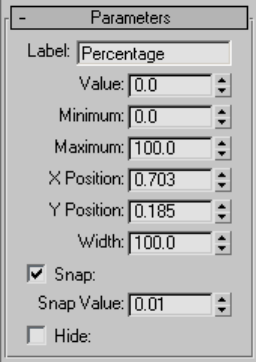
Interface
Label The slider name that appears in viewports. Default=none.
Value The value of the slider, based on the position of the slidable triangle.
Default=0.0.
Minimum The minimum possible value of the slider. Default=0.0.
Maximum The maximum possible value of the slider. Default=100.0.
When the minimum is 0.0 and the maximum is 100.0, the slider Value can
represent a percentage.
X Position The slider's X location in the active viewport. Default=Viewport
X location you clicked when you created the slider.
Y Position The slider's Y location in the active viewport. Default=Viewport
Y location you clicked when you created the slider.
Width The slider's width, in 3ds Max units. Default=100.0.
Snap When on, the slider "snaps" to incremental values determined by the
Snap Value setting. Default=on.
Snap Value The increment used by the slider when Snap is on. Default=0.01.
Hide When on, hides all of the slider except for the label and the move and
show/hide components. Default=off.
Slider Manipulator | 2563
Grid Commands
Views menu > Grids
The Grids submenu provides functions to manipulate the home grid on page
7808 and grid objects on page 7805 .
The Snaps system uses grids both as visual references and as physical snap
references. In addition, grids serve as construction planes, since the objects
you create are built on the active grid in the active viewport.
As a default, the software uses a construction grid called the home grid. The
home grid is the basic reference system, and is defined by three fixed planes
on the world coordinate axes. It provides ready-to-use construction planes,
intersecting at right angles through the origin. When the home grid is
displayed, each orthographic viewport on page 7877 is coplanar (parallel) with
one of the grid faces.
A custom grid, or grid object, is a helper object that you can use in place of
the home grid. While the home grid is three intersecting planes whose
orientation is fixed in world space, a grid object is a free-floating, 2D grid that
you can position and rotate anywhere, letting you construct objects at any
angle in world space. You can also automatically create grids on the surface
of objects by using AutoGrid on page 2513 .
The Grids submenu contains the following commands:
Show Home Grid on page 2564
Activate Home Grid on page 2565
Activate Grid Object on page 2566
Align Grid to View on page 2566
Show Home Grid
Views menu > Grid > Show Home Grid
Right-click a viewport label. > Show Grid
Keyboard > G
Show Home Grid toggles the display of the home grid on page 7808 in the
active viewport.
2564 | Chapter 11 Precision and Drawing Aids
Grids are used both as visual references and as physical snap references by the
Snap system. In addition, grids are construction planes, since the objects you
create are built on the active grid in the active viewport.
As a default, there is a home construction grid called home grid. The home
grid is the basic reference system, and is defined by three fixed planes on the
world coordinate axes. It provides ready-to-use construction planes, intersecting
at right angles through the origin. When the home grid is displayed, each
orthographic viewport on page 7877 is coplanar (parallel) with one of the grid
faces.
Procedures
To toggle the display of the home grid, do one of the following:
1Choose Views menu > Grids, and click Show Home Grid.
2Right-click a viewport label and click Show Grid on the viewport
right-click menu.
3Press G on the keyboard.
Activate Home Grid
Activate a grid other than the Home grid. > Views menu > Grids > Activate
Home Grid
This command activates the home grid on page 7808 as the construction grid,
and deactivates the active grid object on page 7805 .
Procedures
To return to the home grid, do one of the following:
1Choose Views menu > Grids > Activate Home Grid.
2Right-click the selected grid object, and choose Activate Home Grid from
the quad menu.
This deactivates the grid object and activates the home grid in all views.
Activate Home Grid | 2565
Activate Grid Object
Select a grid object. > Views menu > Grids > Activate Grid Object
This command activates the selected grid object on page 7805 as the
construction grid and deactivates the home grid on page 7808 . This menu item
is available only when a grid object is selected.
Procedures
To activate a grid object:
1Select a grid object.
2Do one of the following:
■Choose Views menu > Grids > Activate Grid Object.
■Right-click the selected grid object and choose Activate Grid from the
quad menu.
The grid object changes to show its internal grid structure. Except for
its main axes, the home grid disappears in all viewports.
3Right-click the selected grid object and choose Activate Grid from the
quad menu.
The grid object changes to show its internal grid structure. Except for its
main axes, the home grid disappears in all viewports.
Align Grid to View
Activate a grid object. > Views menu > Grids > Align Grid to View
This command aligns a grid object on page 7805 with the current view. The
grid object is aligned so that it's coplanar with the view and oriented with the
top of the grid at the top of the view.
Procedures
To align a grid object with a viewport:
1Activate a grid object.
2Click or right-click in a viewport.
2566 | Chapter 11 Precision and Drawing Aids

3Right-click to open the quad menu.
4In the Tools 1 quadrant, choose Align Grid to View.
The grid object rotates to align itself with the selected view. The grid
object is now planar, or parallel, with the viewport.
5Choose Views menu > Grids > Align Grid to View.
The grid object rotates to align itself with the selected view. The grid
object is now planar, or parallel, with the viewport.
Snap Commands
main toolbar > Snap buttons
Snaps help you precisely control the dimensions and placement of objects
when you create them or transform them. There is also a Spinner snap for
controlling the entry of values.
You can use objects within an XRef scene as snap references.
The snap commands listed below and described in this section are found on
the main toolbar (except for Ortho and Polar; see their topics for details) .
2D Snap, 2.5D Snap, 3D Snap on page 2568
Angle Snap Toggle on page 2570
Percent Snap Toggle on page 2571
Spinner Snap Toggle on page 2572
Ortho Snapping Mode on page 2573
Polar Snapping Mode on page 2575
Snap Commands | 2567

2D Snap, 2.5D Snap, 3D Snap
Main toolbar > 2D Snap, 2.5D Snap, or 3D Snap on the Snaps Toggle flyout
Keyboard > S
The buttons on the Snaps Toggle flyout on page 7789 provide control over the
range of 3D space where snaps are active. A wide variety of snap types is
available from the Snaps dialog on page 2578 , which you can use to activate
different snap types as you work.
2D, 2.5D, 3D Snaps flyout
Object Snapping
Object snapping lets you snap to specific portions of existing geometry during
creation and transforms of objects or sub-objects. You can also snap to the
grid, and you can snap to tangents, midpoints, pivot points, face centers and
other options.
The mode you choose maintains its state when you switch levels.
Transforming Around Snap Points
When snapping is on and Auto Key on page 7344 is off, rotations and scales
occur about the snap point. For example, if you're using Vertex snapping and
you're rotating a box, you can rotate it about any of its corner vertices. See
To use snaps to move an absolute distance: on page ? below.
When Auto Key is on and either Select And Rotate or Select And Scale is active,
the Snaps Toggle button is disabled, and rotation and scaling take place about
the pivot point of the object.
2568 | Chapter 11 Precision and Drawing Aids

Procedures
To turn snap off during a transform:
■Press S to toggle snapping off when it gets in the way. Press S again to turn
it back on.
To use snaps to move a relative distance:
1Turn on Snaps with the S key, or by clicking the Snaps Toggle button.
2 Lock your selection set with the spacebar, or by clicking Lock
Selection on the status bar.
3Wherever you click in the viewport, the snap will stay relative to the
distance of your cursor to the object.
To use snaps to move an absolute distance:
1Turn on Snaps Toggle.
2Click the selection. Snap uses the point you click for the snap source.
3Move to whatever target snap you desire. The object will snap to an
absolute distance.
To rotate a box around a vertex using snaps:
1Make sure the Auto Key button is off.
2Select the box.
3On the Main toolbar, click Select And Rotate.
4Turn Snaps on by pressing S on the keyboard.
5On the Customize menu, choose Grid And Snap Settings. Turn on Vertex
and turn off Grid Points.
6 Lock your selection set by clicking Lock Selection on the status bar.
7On the toolbar, choose Use Transform Coordinate Center (hold the mouse
down on Use Pivot Point Center to expose the flyout).
2D Snap, 2.5D Snap, 3D Snap | 2569
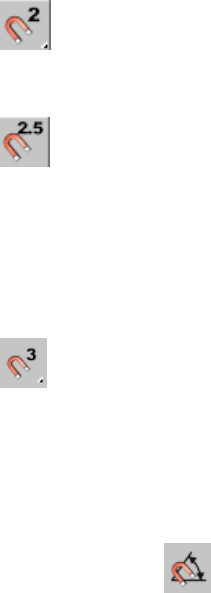
8Move your cursor over any vertex in the box. The blue snap cursor will
appear, and then you can rotate the box around that vertex.
Interface
There are three snap modes:
2D Snap The cursor snaps only to the active construction grid,
including any geometry on the plane of that grid. The Z axis, or vertical
dimension, is ignored.
2.5D Snap The cursor snaps only to the vertices or edges of the
projection of an object onto the active grid.
Suppose you create a grid object on page 7805 and make it active. You then
position the grid object so you can see through the grid to a cube further off
in 3D space. Now with 2.5D set, you can snap a line from vertex to vertex on
the distant cube, but the line is drawn on the active grid. The effect is like
holding up a sheet of glass and drawing the outline of a distant object on it.
3D Snap This is the default tool. The cursor snaps directly to any
geometry in 3D space. 3D snapping lets you create and move geometry in all
dimensions, ignoring the construction plane.
Right-click this button to display the Grid and Snap Settings dialog on page
2578 , which lets you change snap categories and set other options.
Angle Snap Toggle
Main toolbar > Angle Snap Toggle
Keyboard > A
Angle Snap Toggle determines the incremental rotation for a number of
features, including the standard Rotate transform. As you rotate an object (or
group of objects), the object moves around a given axis in the increment you
set.
2570 | Chapter 11 Precision and Drawing Aids

Angle Snap Toggle also affects Pan/Orbit camera controls, FOV on page 7776
and Roll camera settings, and Hotspot/Falloff on page 7811 spotlight angles.
Procedures
To turn angle snap on:
■Click Angle Snap Toggle on the Main toolbar. When turned on, angle snap
affects all rotational transforms.
To rotate an object an even number of degrees:
■Turn on Angle Snap Toggle and rotate the object.
The rotations take place in 5-degree increments as a default.
To rotate an object a precise degree of rotation, do one of the following:
1Click Select And Rotate, then right-click it to display the Transform
Type-In dialog on page 874 . Enter the exact rotation you want.
2Choose Select And Rotate from the quad menu, then right-click it to use
the Transform Type-In dialog on page 874 . Enter the exact rotation you
want.
3Right-click Angle Snap Toggle and click the Options tab on the dialog
that is displayed. Set the Angle value in the General group to the precise
degree of rotation you need, then rotate the object. Rotation snaps to the
angle increment you specified.
Interface
The angle increment is set on the Options panel of the Grid and Snap Settings
dialog on page 2577 . Right-click the Angle Snap Toggle button to display the
Options panel of the Grid and Snap Settings dialog. The default is 5 degrees.
Percent Snap Toggle
Main toolbar > Percent Snap Toggle
Keyboard > Ctrl+Shift+P
Percent Snap Toggle increments scaling of objects by the specified percentage.
Percent Snap Toggle | 2571

Interface
The snap percent increment is set in the Grid And Snap Settings dialog. The
default is 10 percent. Right-click the Percent Snap Toggle button to display
the Grid and Snap Settings dialog on page 2577 .
This is a general-purpose snap system that applies to any operation involving
a percentage, such as scaling or squashing.
Spinner Snap Toggle
Main toolbar > Spinner Snap Toggle
Spinner Snap Toggle sets the single-click increment or the decrement value
for all of the spinners in 3ds Max.
Procedures
To set and toggle spinner snap:
1Do one of the following:
■Choose Customize menu > Preferences.
■Right-click the Spinner Snap Toggle button on the main toolbar.
Either method opens the Preference Settings dialog > General panel.
The two controls for spinner snap are in the Spinners group on this
panel.
2Set a value in the Snap field.
3Turn on Use Snap.
When you exit the dialog, the Spinner Snap Toggle button is turned on.
4As you work, use the Spinner Snap Toggle button to toggle the alternate
setting.
Interface
The amounts for Spinner Snap are controlled by settings on the General panel
on page 7536 of the Preferences dialog. Default=1.0.
2572 | Chapter 11 Precision and Drawing Aids

Ortho Snapping Mode
When drawing a Line spline on page 551 or Wall object on page 456 , Ortho
Snapping Mode constrains line creation to the horizontal or vertical directions
relative to the active grid. That is, with Ortho on, you can draw only lines
that are parallel to lines of the active grid. Ortho is particularly useful for
drawing plans where all lines must be at 90 degrees to each other, such as a
house plan. To constrain line-drawing to other angle increments, use Polar
Snapping Mode on page 2575 instead.
IMPORTANT By default, Ortho Snapping Mode is not directly accessible in the
3ds Max user interface. To add it as a button on the Snaps toolbar, follow this
procedure on page ? .
The following provisions apply to using Ortho:
■Use of Ortho is mutually exclusive of use of the Polar Snapping Mode
toggle on page 2575 ; only one can be active at a time.
■Ortho Snapping applies primarily to the creation of line splines and wall
objects. It can be used while creating other objects, but results are likely
to be unsatisfactory.
Ortho mode displays a compass which gives a readout of the current angle of
the input relative to the positive direction of the local X axis.
NOTE If you hold down the Alt key in Ortho mode, the next point becomes doubly
constrained by both the previous point and the first point of the current object.
This allows you to close splines precisely. In this mode, two compasses are
displayed; one each at the first and previous points.
Procedures
To add Ortho Snapping Mode to the Snaps toolbar:
1Open the Snaps toolbar, if necessary. To do so, right-click an empty part
of the main toolbar, such as the area directly below one of the drop-down
lists, and choose Snaps.
2Drag the right end of the toolbar to the right to make room for a new
button.
3Choose Customize menu > Customize User Interface.
Ortho Snapping Mode | 2573
This opens the Customize User Interface dialog.
4On the dialog, click the Toolbars tab.
5Scroll down the Action list on the dialog to the Ortho Snapping Mode
item. You can jump to the O section by clicking any item in the list and
then pressing O on the keyboard.
6Drag the Ortho Snapping Mode item from the list to the empty section
of the Snaps toolbar. This adds the button to the toolbar.
7Close the Customize User Interface dialog.
3ds Max automatically saves the toolbar in its revised state and makes
the new button a permanent part of the user interface.
To use Ortho:
1Turn on the Ortho Snapping Mode button.
The button appears depressed.
2Begin to draw a Line spline.
An orange compass appears where you place the first point, along with
a red number indicating the angle of the current line segment with the
positive direction of the local X axis.
3Move the mouse cursor around in the viewport.
The line jumps to 90-degree angle increments on the local X axis, while
the compass reading updates to show the current angle.
4Click to place the next vertex.
5Repeat steps 3 and 4 until you're ready to complete the shape.
6Do either of the following:
■To finish the shape at the most recent vertex without closing it,
right-click anywhere.
■To finish the shape by closing it, position the mouse cursor close to
the first point and then click. A small dialog opens asking if you want
to close the spline; click Yes.
2574 | Chapter 11 Precision and Drawing Aids
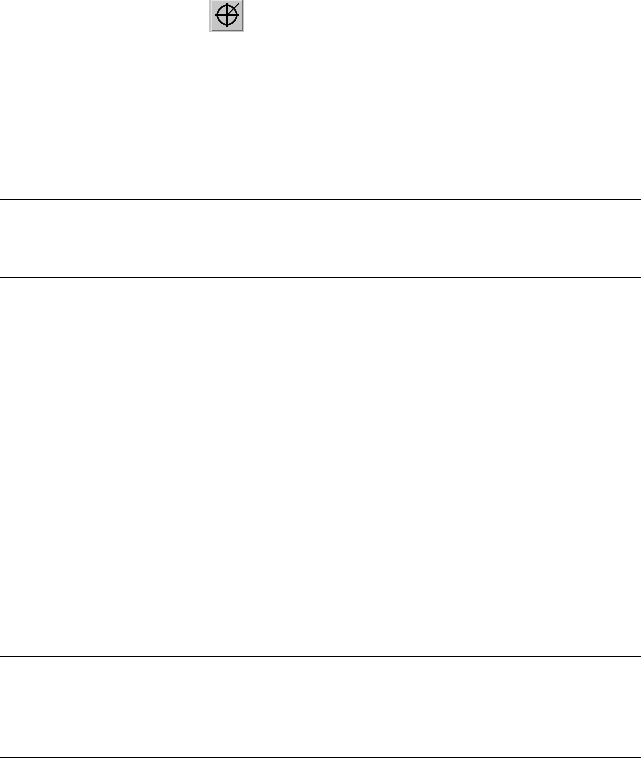
Polar Snapping Mode
When drawing a Line spline on page 551 or Wall object on page 456 , Polar
Snapping Mode constrains line creation to angle increments determined by
the Angle Snap setting relative to the active grid. To change the Angle Snap
setting, right-click the Angle Snap Toggle button on the main toolbar and in
the Options panel > General group, edit the Angle setting.
IMPORTANT By default, Polar Snapping mode is not directly accessible in the
3ds Max user interface. To add it as a button on the Snaps toolbar, follow this
procedure on page ? .
Polar is particularly useful for drawing plans where angles between all lines
must conform to specific angle increments, such as 45 degrees. If all lines must
be at 90-degree angles to each other, use the Ortho Snapping Mode toggle
on page 2573 instead.
The following provisions apply to using Polar:
■Use of Polar is mutually exclusive of use of the Ortho toggle; only one can
be active at a time.
■Polar applies primarily to the creation of line splines and wall objects. It
can be used while creating other objects, but results are likely to be
unsatisfactory.
Polar mode displays a compass that provides a readout of the current angle
of the input relative to the positive direction of the local X axis.
NOTE If you hold down Alt in Polar mode, the next point becomes doubly
constrained by both the previous point and the first point of the current object.
This allows you to close splines precisely. In this mode, two compasses are
displayed; one each at the first and previous points.
Procedures
To add Polar Snapping Mode to the Snaps toolbar:
1Open the Snaps toolbar, if necessary. To do so, right-click an empty part
of the main toolbar, such as the area directly below one of the drop-down
lists, and choose Snaps.
2Drag the right end of the toolbar to the right to make room for a new
button.
Polar Snapping Mode | 2575
3Choose Customize menu > Customize User Interface.
This opens the Customize User Interface dialog.
4On the dialog, click the Toolbars tab.
5Scroll down the Actions list on the dialog to the Polar Snapping Mode
item. You can jump to the P section by clicking any item in the list and
then pressing P on the keyboard.
6Drag the Polar Snapping Mode item from the list to the empty section
of the Snaps toolbar. This adds the button to the toolbar.
7Close the Customize User Interface dialog.
3ds Max automatically saves the toolbar in its revised state and makes
the new button a permanent part of the user interface.
To use Polar:
1Turn on the Polar Snapping Mode button.
The button appears depressed.
2Begin to draw a line spline.
An orange compass appears where you place the first point, along with
a red number indicating the angle of the current line segment with the
positive direction of the local X axis.
3Move the mouse cursor around in the viewport.
The line jumps to specific angle increments from the X-axis, while the
compass reading updates to show the current angle. You set the angle
increment in the Grid And Snap Settings dialog > Options panel on page
2587 > General group, which you can access by right-clicking the Angle
Snap Toggle button on the main toolbar.
4Click to place the next vertex.
5Repeat steps 3 and 4 until you're ready to complete the shape.
2576 | Chapter 11 Precision and Drawing Aids

6Do any of the following:
■To finish the shape at the most recent vertex without closing it,
right-click anywhere.
■To finish the shape by closing it, position the mouse cursor close to
the first point and then click. A small dialog opens asking if you want
to close the spline; click Yes.
■To finish the shape by closing it while constraining the line to the
polar snap, first position the mouse cursor close to the first point,
press and hold Alt to constrain the mouse by both the previous point
and the first point, and then click. This vertex is automatically placed
at the current angle increment from the first point, so that you need
only click the first point to close the shape.
Grid and Snap Settings
Customize menu > Grid and Snap Settings
Right-click any snap button
This command displays the Grid and Snap Settings dialog. This modeless
dialog establishes settings and options for snaps, the home grid on page 7808
, and user-defined grids.
Controls on the Grid And Snap Settings dialog determine which snap settings
are used when you activate snaps by clicking 3D Snap Toggle. Adjusting any
of these snap settings does not automatically turn on snaps.
You can use objects within an XRef scene as snap references.
The Grid And Snap Settings dialog contains tabs for:
Snap Settings on page 2578
Snap Options on page 2587
Home Grid Settings on page 2592
User Grids Settings on page 2595
Grid and Snap Settings | 2577
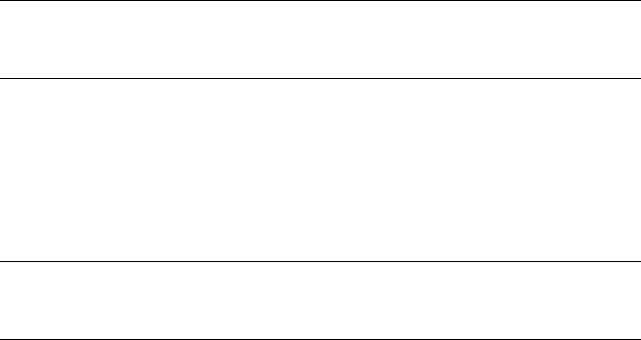
Procedures
To change grid and snap settings:
1Choose Customize menu > Grid And Snap Settings and click the
appropriate tab.
2Choose the type of snap you want (Standard or NURBS).
3Select the snap settings.
Snap Settings
Customize menu > Grid And Snap Settings > Grid And Snap Settings dialog
> Snaps tab
Main toolbar > Right-click a snap button
Keyboard > Hold Shift+right-click > Snaps quadrant
Keyboard > S (toggles snaps on and off)
Snapping gives you additional control when creating, moving, rotating, and
scaling objects by causing the cursor to “jump” to specific portions of existing
geometry and other scene elements during creation and transformation of
objects or sub-objects. The controls in this dialog set the snap strength and
other characteristics such as the snap target.
NOTE Snapping functionality includes several features that enhance ease of use.
For details, see the General Group section of the Snap Options topic on page 2590
.
You can specify the portion of the geometry where you will snap. For example,
when Vertex is the active snap type, creating and transforming objects snaps
to the vertices of existing geometry. You can specify any combination of active
snap types to provide multiple snapping points. For example, if Vertex and
Midpoint are active, snapping occurs at both vertices and edge midpoints.
The default snap type is Grid Points .
NOTE Snapping is not on by default. You can toggle snapping by pressing the
S key at any time, even in the middle of a transform. In this way you can combine
snapping with free positioning.
2578 | Chapter 11 Precision and Drawing Aids

Snapping works at sub-object levels. For example, you can use snaps to position
a gizmo to the object on which you're working, or snap it to other objects in
the scene.
You must activate a viewport in order to use snaps. Also, the Z-axis constraints
don't apply to the home grid or grid objects, since grids don't have a Z axis.
Settings are stored in the 3dsmax.ini on page 51 file. The state of the snap
settings persists from session to session.
Snaps and Axis Constraints
Snaps take precedence over axis constraints on page 884 . If you activate an
axis constraint, such as Restrict to X, you can move the object only in X. But
if you then turn on snaps, Restrict to X is suspended and not used.
You can override this by turning on Snaps Use Axis Constraint Toggle on the
Axis Constraints toolbar on page 7288 , or by turning on Use Axis Constraints
in Snap Options on page 2587 .
The Snaps Toolbar
The most common Snaps settings are available from an optional toolbar. To
toggle display of the Snaps toolbar, right-click an empty area of the main
toolbar, such as the section under the Reference Coordinate System drop-down,
and choose Snaps. The toolbar buttons are shown next to the relevant
commands, below and in the Snap Options topic on page 2587 .
The same settings are also available from the snap quad menu, available with
Shift+right-click.
Procedures
To set grid and snap settings:
1Turn on the 3D Snap Toggle button to activate snaps.
2Choose Customize > Grid And Snap Settings to display the Grid and Snap
Settings dialog.
Snap Settings | 2579

3In the Snaps tab, select one or more of the types of snaps you want active.
4Create an object or t ransform an object.
Snap markers appear when the mouse cursor is over existing geometry
or on a grid, depending on the active snap types. Each snap type has a
different display; clicking when the snap-specific display is visible snaps
to that spot.
To display the Snaps shortcut menu:
■Hold Shift and right-click anywhere in any viewport. The quad menu that
opens gives you access to various snap settings including Snaps Use Axis
Constraints and Snap To Frozen Objects.
To use both constraint and snaps, do one of the following:
1In the Grid and Snap Settings dialog > Options tab > Translation group,
turn on Use Axis Constraints.
2Hold Shift and right-click in the viewport, and then choose Options >
Transform Constraints from the Snap quadrant.
Example: To use 3D snaps and rotation transformations together:
1Create a box.
2Select the box and choose Lock Selection.
3Turn on 3D Snaps and click Rotate on the toolbar.
4 From the Use Center flyout on the main toolbar, choose Use
Transform Coordinate Center on page 908 .
5Activate the Perspective viewport and move the cursor over the grid.
A blue icon displays when the cursor passes over a grid point.
6When the blue icon displays, click and drag to rotate the box around the
selected grid point.
You can rotate around anything you can snap to.
To turn snaps on and off during an operation:
■Use the S keyboard shortcut to turn snap on and off.
2580 | Chapter 11 Precision and Drawing Aids
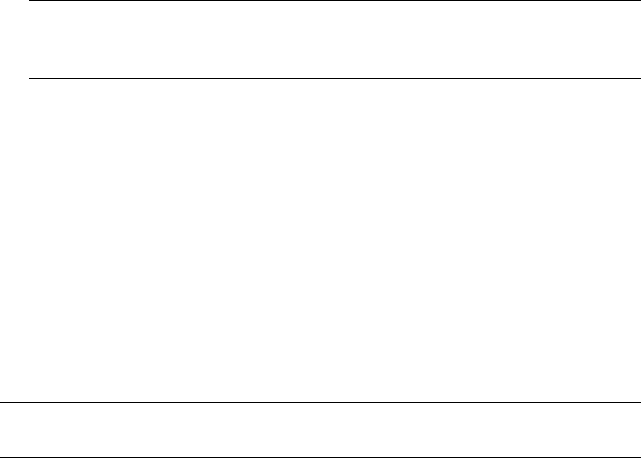
TIP You can select something with snap off, and then turn snap on to snap it
to a snap target. Alternately you might want to snap to something, then
position it freely wherever you want.
Interface
Use these check boxes on the Snaps tab to turn on any combination of snap
settings.
After setting snaps, close the dialog using the Close button in the dialog's
upper-right corner. Do not click the Clear All button, or you'll turn off all the
snaps.
Override This label changes to display the temporary snap type used by the
Override system. For more information, see Snap Override on page 2585 .
Clear All Turns off all of the Snaps check boxes.
NOTE The layout of the Grid And Snap Settings dialog is generated at runtime.
Because of this, it might appear slightly different than the illustrations shown here.
Snap Settings | 2581
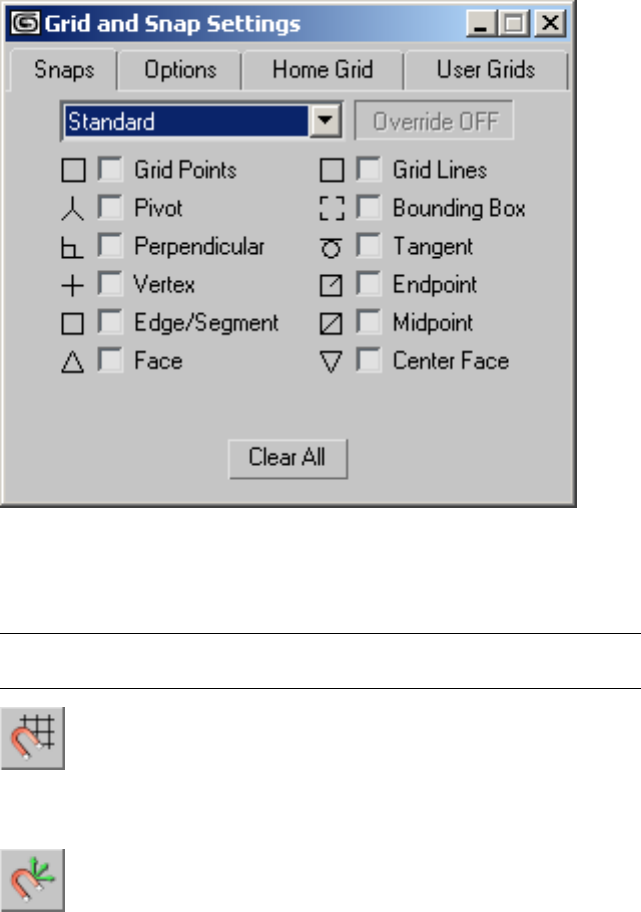
Standard snaps
These are the standard snap types used for grids, mesh, and shape objects.
Non-grid snap types, when active, take priority over Grid Points and Grid
Lines snaps: if the mouse is equally near a grid point and some other snap
type, it will choose the other snap type.
NOTE The button images shown below are from the Snaps toolbar on page 2579
.
Grid Points Snaps to grid intersections. This snap type is on by
default. Keyboard shortcut=Alt+F5.
Grid Lines Snaps to any point on a grid line.
Pivot Snaps to pivot points of objects. Keyboard shortcut=Alt+F6.
2582 | Chapter 11 Precision and Drawing Aids

Bounding Box Snaps to one of the eight corners of an object's bounding
box.
Perpendicular Snaps to the perpendicular point on a spline, relative to the
previous point.
Tangent Snaps to a tangent point on a spline, relative to the previous point.
Vertex Snaps to vertices of mesh objects or objects that can be
converted to editable meshes. Snaps to segments on splines. Keyboard
shortcut=Alt+F7.
Endpoint Snaps to the end points of edges on meshes or spline vertices.
Keyboard shortcut=Alt+F8
Edge/Segment Snaps anywhere along edges (visible or invisible) or
spline segments. Keyboard shortcut=Alt+F10.
Midpoint Snaps to the middle of edges on meshes and spline
segments. Keyboard shortcut=Alt+F9.
Face Snaps anywhere on the surface of a face. Back faces are culled,
so they have no effect. Keyboard shortcut=Alt+F11.
Center Face Snaps to the center of triangular faces.
Snap Settings | 2583
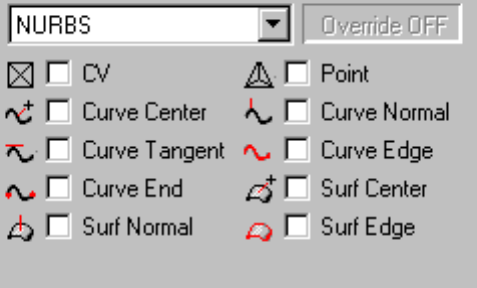
NURBS Snaps
These options snap to objects or sub-objects in a NURBS model on page 7865 .
The NURBS snaps settings are aids for creating and transforming objects, and
are not constraints. The software does not maintain the relationship between
the NURBS object and other objects you create or transform.
CV Snaps to a CV sub-object on page 7750 in a NURBS curve on page 7864 or
NURBS surface on page 7865 .
Point Snaps to a point sub-object on page 7897 in a NURBS model.
Curve Center Snaps to the center of a NURBS curve.
The center of a NURBS curve is calculated parametrically, and might not be
the same as the curve's apparent visual center.
Curve Normal Snaps to a point normal to a NURBS curve.
This snap operates only while you are creating a new object that requires two
or more clicks to create.
Curve Tangent Snaps to a point tangent to a NURBS curve.
This snap operates only while you are creating a new object that requires two
or more clicks to create.
Curve Edge Snaps to the edge of a NURBS curve (the current object moves
or is created to lie along the curve).
Curve End Snaps to the end of a NURBS curve.
Surf Center Snaps to the center of a NURBS surface.
2584 | Chapter 11 Precision and Drawing Aids

The center of a NURBS curve is calculated parametrically, and might not be
the same as the curve's apparent visual center.
Surf Normal Snaps to a point on a NURBS surface normal to previous point.
This snap operates only while you are creating a new object.
Surf Edge Snaps to the edge of a NURBS surface.
Snap Override
Any viewport > Hold Shift and right-click. > Standard > Choose snaps type.
Customize menu > Grid and Snap Settings > Snaps tab
Snap Override lets you supersede all the currently selected snap types and
temporarily use only one, or none, of the snap types currently selected on the
Grid and Snap Settings dialog. For example, you might be creating a spline
while snapping to grid points, but then need to snap one of its vertices to the
midpoint of an object.
TIP You can choose the override by cycling through active snap types via a
keyboard shortcut instead of using the quad menu. Press Alt+S repeatedly to
choose the override snap type. If the Grid and Snap dialog is displayed, the
"Override OFF" label changes to display the selected snap type.
Procedures
To use Snap Override (keyboard shortcut method):
1Activate all the snap types you want to use or override with.
2Make sure the Grid And Snap Settings dialog is open to the Snaps panel,
so you can easily track the override type. Alternatively, if you're using
only snap types available on the Snaps toolbar on page 2579 , you can keep
the toolbar open instead.
3While creating or moving an object with Snap on, press Alt+S repeatedly.
The Grid And Snap Settings dialog > "Override OFF" label changes to
display the first available override snap type, chosen from the active snap
types. If the Snaps toolbar is open, and the override snap type is available
on the toolbar, the override snap type is visible there as well.
4Press Alt+S repeatedly.
Snap Override | 2585
The software cycles through all the active snap types for the override
type.
The benefit of this method is that it's fast and easy; you don't have to
use the quad menu. But if you want to override with a snap type that
isn't currently active, it's necessary to use the standard override method,
which is described in the next procedure.
To use Snap Override (standard method):
1While creating or moving an object with Snap on, hold down Shift and
right-click in a viewport.
2Select one of the snap types from the sub-menus in the Snap Override
quadrant to make it the only active snap type.
If the Grid And Snap Settings dialog is open to the Snaps panel, the
"Override OFF" label changes to display the active snap override type.
When you complete the mouse action, "Override OFF" is again displayed
in the dialog, and the previously active snap types are active again.
To use Snap Override during a drag operation:
1Left-click, press Shift, and then right-click to display the menu.
2Release the left mouse button, and then left-click to select the snap you
want.
3Release the Shift key, right-click, and continue the drag operation (the
geometry remains locked to the mouse).
4Left-click to complete the operation.
Interface
In addition to the available snap types, the snap quad menu contains these
items:
Snap Options quadrant Lets you set the following options:
■Grid and Snap Settings: Toggles display of the Grid And Snap Settings
dialog.
■Snaps To Frozen Objects: Turn this on to enable snapping to frozen objects.
Default=off.
2586 | Chapter 11 Precision and Drawing Aids
■Snaps Use Axis Constraints: Turn this on to use the current transform
constraints. For example, if you're moving a vertex with Restrict To XY
Plane on and want to snap the vertex to a point removed on the Z axis,
turn this off, if necessary. Default=off.
Snap Override quadrant Lets you set the following options:
NURBS/Standard Let you choose a snap type for one-time use. This applies
to the next snap only.
None Turns off all snap types for the next mouse action. (This item is
unavailable if the Snap Toggle is off.)
[last] Displays the last snap override type you chose from the NURBS or
Standard submenu, letting you easily reuse that type.
Snap Toggles quadrant Lets you set six of the most common snap types on
an ongoing basis. These remain in effect until you turn them off; it's the same
as setting them on the Grid And Snap Settings dialog.
Snap Options
Customize menu > Grid and Snap Settings > Grid and Snap Settings dialog >
Options panel
Main toolbar > Right-click 3D Snap Toggle > Grid and Snap Settings dialog >
Options panel
The Options panel of the Grid And Snap Settings dialog lets you set options
related to snapping.
Procedures
To set snap options:
1Choose Customize menu > Grid And Snap Settings.
2Click the Options tab.
3Set the options as desired.
Example: To use Snap Preview:
The Snap Preview Radius setting lets you preview a snap before it actually
happens. The Snap Radius setting determines when actual snapping occurs,
providing the same functionality as Snap Strength in previous versions.
Snap Options | 2587

This procedure also demonstrates how to cycle through available snap/preview
points with the keyboard shortcut.
1Reset the software, and then maximize the Perspective viewport.
To maximize the Perspective viewport, make sure it's active (yellow
border), and then press Alt+W.
2Zoom in a bit so the grid squares are relatively large.
Snap and Snap Preview measure in pixels, so if the grid points are
relatively far apart, it's easy to see the difference between Snap Preview
and Snap.
3 On the main toolbar, click the Snaps Toggle button to turn on
snapping, and then right-click the button to open the Grid And Snap
Settings dialog to the Snaps panel.
The default Snaps setting is Grid Points only; if this is not the case, make
it so. A grid point is the intersection of two grid lines.
4On the dialog, click the Options tab.
In the General group, Snap Preview Radius is set to 30 pixels and Snap
Radius is set to 20 pixels. You can leave this dialog open while you use
snaps.
5 On the Create panel, click Shapes, and then click Object Type
rollout > Line.
You're now in line-creation mode.
6Click anywhere in the viewport to start creating a line-type spline object.
7Move the cursor around the viewport.
As you do so, a rubber-band line connects the mouse cursor to the start
point.
8Position the mouse cursor near a grid point, but not too close, so that
the snap cursor (cyan box + crosshairs) appears at the grid point, but the
line endpoint remains attached to the mouse cursor.
This shows the snap preview; you'll see its purpose in the next step.
9Click the left mouse button.
2588 | Chapter 11 Precision and Drawing Aids

The second line vertex is created not where you clicked but at the grid
point indicated by the snap preview. Snap preview lets you see where a
snap will occur before it actually happens.
10 Move the cursor toward another grid point.
At the Snap Preview Radius distance (30 pixels), the snap cursor appears
at the grid point.
11 Continue moving the cursor toward the grid point.
After you move it 10 pixels closer (the difference between Snap Preview
Radius and Snap Radius), the line endpoint jumps from the mouse cursor
to the grid point. This is the legacy snap functionality.
12 Click to accept the snap.
13 Complete the line, and then zoom out so the grid points are closer
together. Start another line, and then position the mouse cursor in the
center of a grid square, so the preview snap point appears at one of the
grid points.
14 On the keyboard, press and hold Alt+Shift and then press S repeatedly to
cycle through the remaining nearby grid points. If nothing happens, try
zooming out more or increasing the Snap Preview Radius value.
By default, the software uses the closest snap point as the preview location.
This keyboard shortcut lets you choose other qualifying snap points.
Interface
NOTE The layout of the Grid And Snap Settings dialog is generated at runtime.
Because of this, it might appear slightly different than the illustration shown here.
Snap Options | 2589
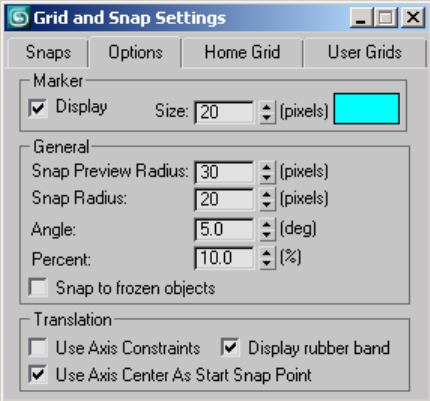
Marker group
Provides settings that affect the visual display of the snap points.
Display Toggles the display of the snap guides. When off, the snaps still
function, but there's no display.
Size Sets the size, in pixels, of the snap "hit" point. This is the small icon
that indicates either the source or target snap point.
Color Click the color swatch to display the Color Selector, where you can
set the color of the snap display.
General group
Snap functionality includes several features that enhance ease of use. When
using Snap, if the cursor comes within distance of a potential snap point that's
less than the Snap Preview Radius distance but greater than the Snap Radius
distance, the snap cursor jumps to that point as a preview of where the snap
will occur, but no actual snapping occurs.
To use the preview point as the snap point, click or release the mouse button,
depending on the context. If, instead, you then continue to move the cursor
toward the potential snap point so that it comes within a distance equal to
or less than the Snap Radius value, the snap takes place.
2590 | Chapter 11 Precision and Drawing Aids
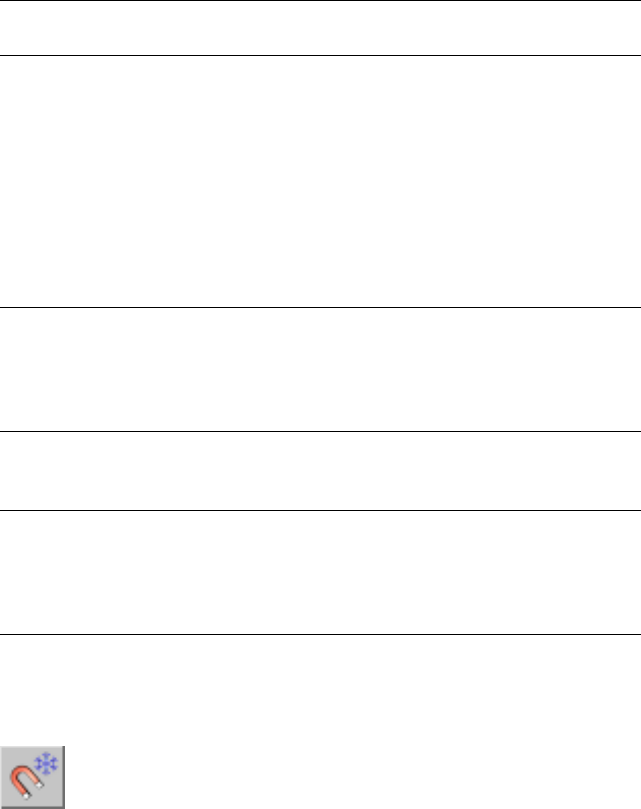
TIP For best results, keep the Snap Preview Radius value 10 pixels or more higher
than the Snap Radius value. This lets you preview any snap before it actually occurs.
Snap Preview Radius When the cursor is a distance from a potential snap-to
point between the Snap Preview Radius value and the Snap Radius value, the
snap marker jumps to the closest potential snap-to point, but no snap occurs.
Default=30.
When a snap-to preview point is highlighted, release or click the mouse button
(depending on the context) to snap the current selection to that location.
Alternatively, before using the displayed snap point, you can cycle though
any other available preview and snap points by pressing and holding Alt+Shift
and then press S repeatedly.
NOTE The Snap Preview Radius value should generally be set higher than the
Snap Radius value, so that previewing occurs before snapping. If you attempt to
set the Snap Preview Radius value lower than the Snap Radius value, the software
lowers the latter so that the two are equal. This effectively turns off previewing,
so that only snapping is in effect.
Snap Radius Sets the size of the area around the cursor, in pixels, within
which snapping occurs automatically. Default=20.
NOTE The Snap Radius value should generally be set lower than the Snap Preview
Radius value, so that previewing occurs before snapping. If you attempt to set the
Snap Radius value higher than the Snap Preview Radius value, the software raises
the latter so that the two are equal. This effectively turns off previewing, so that
only snapping is in effect.
Angle Sets the increment at which objects are rotated about a given axis
(degrees).
Percent Sets the percentage increment for scale transforms.
Snap to Frozen Objects When on, snapping to frozen objects is
enabled. Default=off. This option is also available from the Snaps shortcut
menu, accessed when you hold Shift and right-click in any viewport, as well
as from the Snaps toolbar on page 2579 . Keyboard shortcut=Alt+F2.
Snap Options | 2591

Translation group
Use Axis Constraints Constrains the selected object to move only
along the axes specified on the Axis Constraints toolbar on page 7288 . When
turned off (the default), the constraints are ignored, and snapped objects can
be translated in any dimension (assuming 3D snapping is used). This is also
available from the Snaps shortcut menu, accessed when you hold Shift and
right-click in any viewport, as well as from the Snaps toolbar on page 2579 .
Keyboard shortcut=Alt+F3 or Alt+D.
Display rubber band When on and you move an selection, a rubber-band
line appears between the original location and the mouse position. Use this
visual aid for greater accuracy when fine-tuning Default=on.
Use Axis Center As Start Snap Point Sets the center of the transform axis of
the current selection set to be the initial snap point if there's no other start
snap point detected by the snap system. This option works both at the object
and sub-object levels.
This lets you, for example, snap the geometric center of a multi-object selection
to a grid point.
Home Grid Settings
Customize menu > Grid And Snap Settings > Home Grid panel
Main toolbar > Right-click 3D snap toggle. > Grid And Snap Settings > Home
Grid panel
The Home Grid panel of the Grid And Snap Settings dialog sets the spacing
and other characteristics of the home grid on page 7808 . Choosing useful home
grid settings can simplify the construction process. The home grid provides
a visual reference to use when creating objects in a scene.
In the software, grids have these primary uses:
■An aid in visualizing space, scale, and distance.
■Construction planes where you create and align objects in your scene.
■A reference system for using grid snaps.
2592 | Chapter 11 Precision and Drawing Aids
Procedures
To set grid spacing for unit measure:
1From the menu bar, choose Customize menu > Grid And Snap Settings.
2Click the Home Grid tab.
3Adjust the value for Grid Spacing, which is in current units.
For example, if you have units set to centimeters, you might make one
grid space equal to 1.000 (one unit, or one centimeter in this case).
To set major grid divisions for multiple units:
1From the menu bar, choose Customize menu > Grid And Snap Settings.
2Click the Home Grid tab.
3Adjust the Major Lines Every Nth Grid Line value, which is the number
of grid squares between major lines. The minimum is 2.
For example, if you use a grid spacing of one centimeter, you might use
a value of 10 so the major grid divisions represent one decimeter.
In perspective viewports, you can set a fixed size for the displayed home
grid. If Inhibit Perspective View Grid Resize is turned off however, the
grid size adjusts as you zoom in or out.
To set view update options:
1From the menu bar, choose Customize menu > Grid And Snap Settings.
2Click the Home Grid tab.
3Under Dynamic Update, choose either Active Viewport (the default) or
All Viewports.
To allow subdivision below grid spacing:
1From the menu bar, choose Customize menu > Grid And Snap Settings.
2Click the Home Grid tab.
3Turn off Inhibit Grid Subdivision Below Grid Spacing.
When you turn off this box, you can zoom indefinitely "deep" into any
plane of the home grid. Each grid square subdivides into the same number
of smaller grid spaces.
Home Grid Settings | 2593
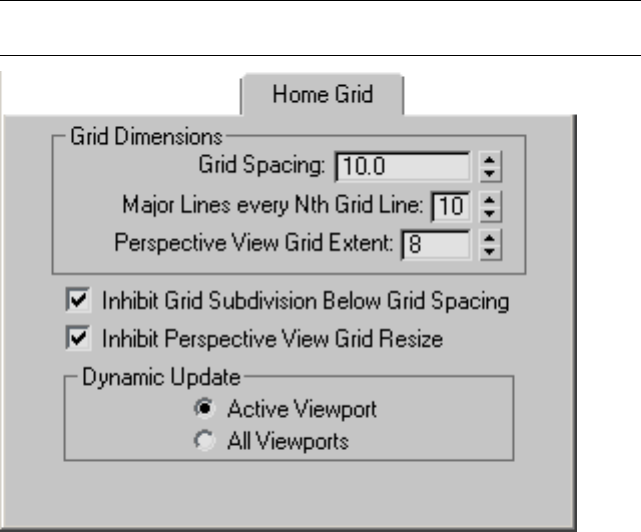
Interface
NOTE The layout of the Grid And Snap Settings dialog is generated at runtime.
Because of this, it might appear slightly different than the illustration shown here.
Grid Dimensions group
Grid spacing Grid spacing is the size of the grid's smallest square. Use this
spinner to adjust the spacing (which is in current units), or enter the value
directly.
For example, if you have units set to centimeters, you might make one grid
space equal to 1.000 (one unit, or one centimeter in this case).
Major Lines every Nth Grid Line The home grid displays heavier or "major"
lines to mark groups of grid squares. Use spinner to adjust the value, which
is the number of grid squares between major lines, or you can enter the value
directly, the minimum is 2.
For example, if you use a grid spacing of one centimeter, you might use a
value of 10 so the major grid divisions represent one decimeter.
Perspective View Grid Extent Sets the size of the home grid in the Perspective
viewport.
2594 | Chapter 11 Precision and Drawing Aids

This value is specified in terms of the Grid Spacing value, and represents the
length of half the grid along an axis. This means that if Grid Spacing=10.0
and Perspective View Grid Extent=7, you will have a grid that is 140 x 140
units in size.
Inhibit Grid Subdivision Below Grid Spacing Causes 3ds Max to treat the
grid as a fixed set of lines when you zoom in on the home grid. In effect, the
grid stops at the grid space setting. If you keep zooming, the fixed grid is lost
from view. Zooming out is not affected. When you zoom out, the home grid
expands indefinitely to maintain the major grid divisions. Default=on.
When this is turned off, you can zoom indefinitely into any plane of the home
grid. Each grid square subdivides into the same number of smaller grid spaces.
For a grid spacing of one centimeter and a major division of 10, the next level
down subdivides into millimeter spaces, and so on.
Inhibit Perspective View Grid Resize Causes 3ds Max to treat the grid in the
Perspective viewport as a fixed set of lines when you zoom in or out. In effect,
the grid maintains one size, no matter how much you zoom. Default=on.
When this is turned off, the grid in the Perspective viewport will subdivide to
adjust its size when you zoom in or out.
Dynamic Update group
Dynamic Update By default, only the active viewport updates as you change
values for Grid Spacing and Major Lines every Nth. The other viewports update
after you have completed changing the values. Choose All Viewports to have
all viewports update as you change the values.
User Grids Settings
Customize menu > Grid And Snap Settings > Grid And Snap Settings dialog
> User Grids tab
The User Grids panel controls automatic activation of grid objects on page
2538 and settings for AutoGrid on page 2513 .
Interface
NOTE The layout of the Grid And Snap Settings dialog is generated at runtime.
Because of this, it might appear slightly different than the illustration shown here.
User Grids Settings | 2595
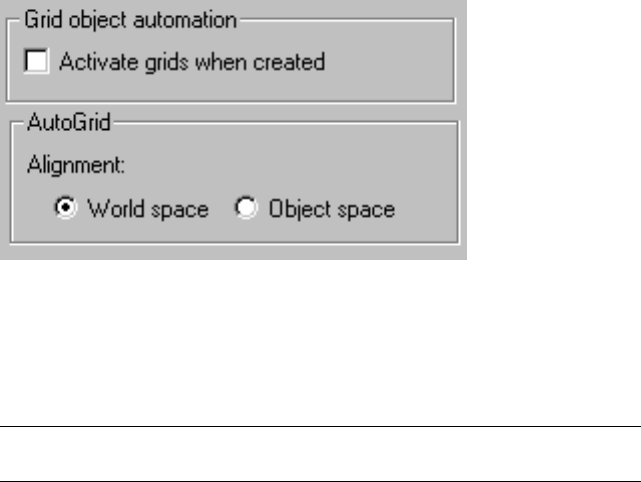
Grid object automation group
Determines if the software automatically makes grids active upon creation.
Activate grids when creating Turn on to automatically activate the grid you
created.
TIP If not turned on, you can activate the grid by selecting the grid, then
right-clicking and choosing Activate Grid.
AutoGrid group
AutoGrid allows you to automatically create grids on the surface of objects.
The task of creating objects that are aligned to other object surfaces has been
simplified. Turn on AutoGrid in the Object Type rollout of a command panel.
When you turn on AutoGrid, the software uses the setting in the User Grids
dialog for world or object space.
World space Aligns grids to world space.
Object space Aligns grids to object space.
Drawing Aid Utilities
The utilities listed here are additional aids to drawing and precision. The
Measure utility returns the measurements of a selected shape or 3D object.
The Rescale World Units utility rescales either a selection or an entire scene.
Use the Utilities panel on page 7463 to open a drawing aid utility and make it
active.
Measure Utility on page 2597
2596 | Chapter 11 Precision and Drawing Aids
Rescale World Units Utility on page 2599
Measure Utility
Utilities panel > Utilities rollout > Measure button
The Measure utility provides measurements of a selected object or shape.
See also:
■Measure Distance Tool on page 2529
Procedures
To measure an object:
1On the Utilities panel, click the Measure button.
2Select the object you want to measure.
If both an object and a shape are in the selection, information is displayed
for both types. If several objects are in a selection, the sum of their
measurements is displayed.
Measure Utility | 2597
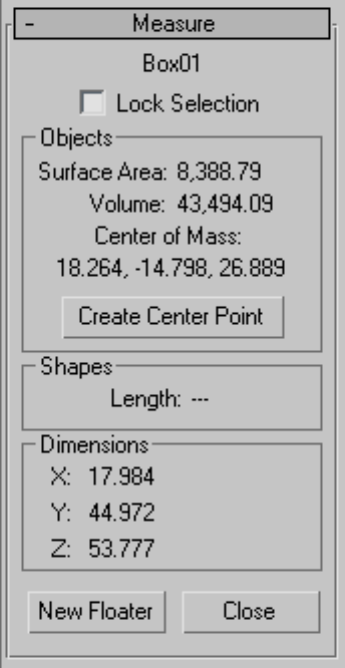
Interface
Text display Displays the name of the object in the current selection. If more
than one object is in the selection, Multiple Objects Selected is displayed.
Lock Selected Prevents the displayed data from changing when you change
selection. For example, you might need to select and manipulate another
object that affects the currently selected object.
Objects group
Displays information about renderable mesh objects.
Surface Area Displays the total surface area of all objects in the selection, in
units squared.
2598 | Chapter 11 Precision and Drawing Aids

Volume Displays the total volume of all objects in the selection, in units
cubed. Note that objects with "holes" caused by missing faces can result in
inaccurate volume values. When an object has one or more holes, an asterisk
appears beside the Volume number.
Center Of Mass Displays the world coordinates of the location of the center
of mass for the object or the center of mass of the selected objects.
Create Center Point Creates a point helper object at the center of mass.
Shapes group
Displays information about shape objects.
Length Displays the sum of the length of all splines in all selected shapes.
Dimensions group
Displays the dimensions of the object, as they appear in world space. For
example, if it were a box with the created dimensions of 15 x 10 x 25, and
that box were scaled 200 percent, then this group would report dimensions
of 30 x 20 x 50.
Button set
New Floater Launches a modeless Measure dialog that displays the same
information found under the Objects, Shapes, and Dimensions groups on the
Utilities panel. In addition, you can expand the dialog horizontally, in case
the values are too long to be viewed in the default dialog size.
TIP While the Measure floater is displayed, you can view the length of a spline
while you're creating it.
Close Closes the utility.
Rescale World Units Utility
Utilities panel > Utilities rollout > More button > Utilities dialog > Rescale
World Units
This utility rescales the world units of either the entire scene or selected objects
in the scene. The Rescale World Units dialog controls scale factor and whether
it is applied to the entire scene or the current selection.
Rescale World Units Utility | 2599
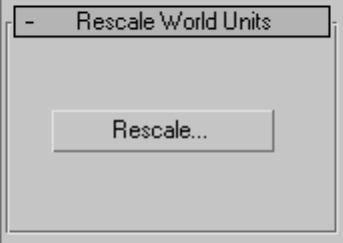
Procedures
To rescale an object:
1Select an object in the viewport.
2On the Utilities panel, click the More button, and on the Utilities dialog,
choose Rescale World Units from the list.
3On the Utilities panel, click the Rescale World Units button.
4On the Rescale World Units rollout, click the Rescale button.
5Set the Scale Factor to the desired scale. For example, setting the scale to
a value of 2.0 doubles the size of the object that it’s applied to.
6In the Affect group, choose the Selection option.
7Click OK to apply the scale.
Interface
Rescale World Units rollout
Rescale After selecting the objects you want to rescale, click this to display
the Rescale World Units dialog.
2600 | Chapter 11 Precision and Drawing Aids
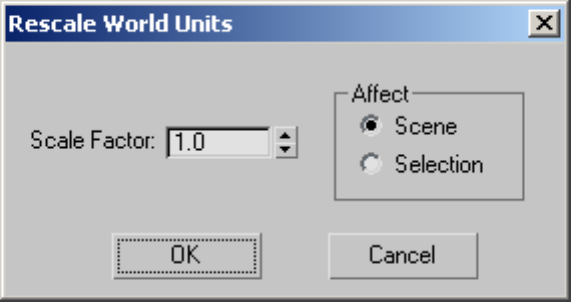
Rescale World Units dialog
Scale Factor Specifies the scaling factor.
Affect
■Scene Applies the scale to the entire scene.
■Selection Applies the scale only to the current selection.
OK Applies the scale.
Cancel Cancels the operation.
Rescale World Units Utility | 2601
2602

Space Warps and
Particle Systems
Space warps and particle systems are additional modeling tools. Space warps are “force fields”
that deform other objects, creating the effect of ripples, waves, blowing wind, and so on.
Particle systems generate particle sub-objects for the purpose of simulating snow, rain, dust,
and so on. (You use particle systems primarily in animations.)
See also:
■Space Warp Objects on page 2603
■Particle Flow on page 2713
■Non-Event-Driven Particle Systems on page 2923
Space Warp Objects
Create panel > Space Warps
Space warps are nonrenderable objects that affect the appearance of other objects.
Space warps create force fields that deform other objects, creating the effect of
ripples, waves, blowing wind, and so on.
Space warps behave somewhat like modifiers, except that space warps influence
world space, rather than object space, as geometric modifiers do.
When you create a space warp object, viewports show a wireframe representation
of it. You can transform the space warp as you do other 3ds Max objects. The
position, rotation, and scale of the space warp affect its operation.
12
2603
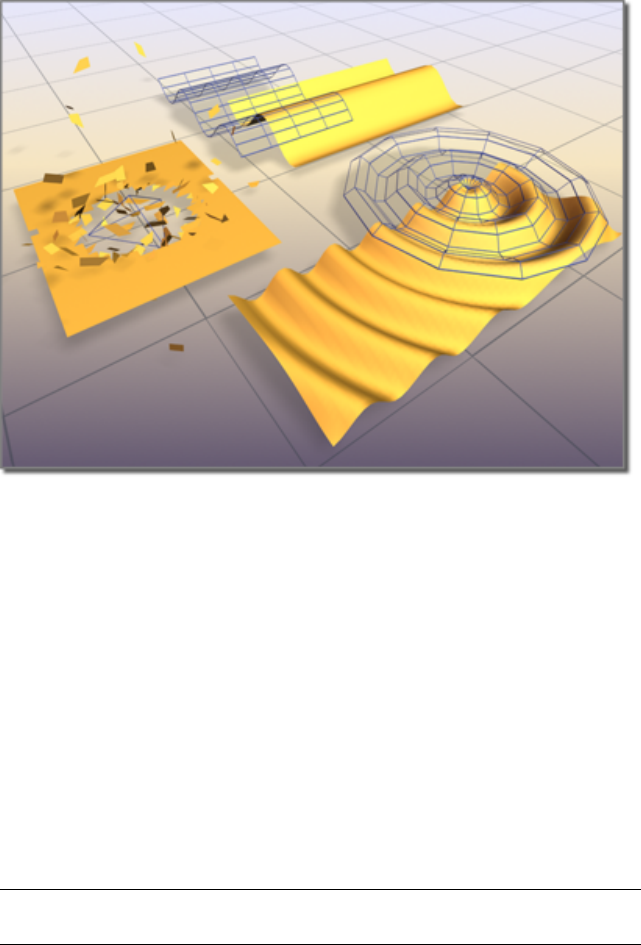
Surfaces deformed by space warps
Left: Bomb
Right: Ripple
Rear: Wave
A space warp affects objects only when the objects are bound to it on page
2609 . The warp binding appears at the top of the object's modifier stack. A space
warp is always applied after any transforms or modifiers.
When you bind multiple objects to a space warp, the space warp's parameters
affect all the objects equally. However, each object's distance from the space
warp or spatial orientation to the warp can change the warp's effect. Because
of this spatial effect, simply moving an object through warped space can
change the warp's effect.
You can also use multiple space warps on one or more objects. Multiple space
warps appear in an object's stack in the order you apply them.
NOTE You can take advantage of the AutoGrid feature to orient and position new
space warps with respect to existing objects. See AutoGrid on page 2513 for details.
2604 | Chapter 12 Space Warps and Particle Systems

Space Warps and Supported Objects
Some types of space warps are designed to work on deformable objects, such
as geometric primitives, meshes, patches, and splines. Other types of warps
work on particle systems such as Spray and Snow.
Five space warps (Gravity, PBomb, Wind, Motor, and Push) can work on
particle systems and also serve special purposes in a dynamics simulation. In
the latter case, you do not bind the warps to objects, but rather assign them
as effects in the simulation.
On the Create panel, each space warp has a rollout labeled Supports Objects
Of Type. This rollout lists the kind of objects you can bind to the warp.
Basics of Using Space Warps
Follow these general steps to use space warps:
1Create the space warp.
2Bind objects to the space warp.
Click Bind To Space Warp on the main toolbar (available from the
Select And Link flyout), and then drag between the space warp and the
object.
The space warp has no visible effect on your scene until you bind an
object, system, or selection set to it.
3Adjust the space warp's parameters.
4Transform the space warp with Move, Rotate, or Scale. The transforms
often directly affect the bound object.
You can animate space warp parameters and transforms. You can also animate
space warp effects by animating transforms of an object bound to the warp.
Particle Leakage and Deflector Space Warps
A deflector is a space warp that acts as a barrier to particles in particle systems.
Occasionally stray particles can leak through a deflector under the following
circumstances:
■When a particle happens to hit the deflector too near the end or beginning
of a time interval, and numerical error in the solution doesn't report a hit
Space Warp Objects | 2605
■When a particle hits too near the edge of a face referenced by a UDeflector,
and neither face finds it
■When a particle is moving quickly and first appears too close to the
deflector, so the very first update cycle within the particle system takes it
past the deflector without the deflector ever seeing it
Often this isn't a problem because the particles bounce off solid objects, so
you don't see the errant particles. When it does cause problems, you can use
a planar deflector instead of a UDeflector, a collection of planars to
approximate the mesh, or a simple mesh to replace the planar. The solutions
vary, so where one has a glitch the other might work just fine.
If particles are moving fast and the deflector is in a particular position (for
example, it might be too close to the emitter) many particles can leak through
defectors. Sometimes you can fix this leakage by changing the particle system's
Subframe Sampling setting or the particle speed. Other times you must
reposition the deflector farther away from the emitter.
In addition, particles imbued with bubble motion on page 2991 can leak
through deflectors, particularly when set to high amplitudes. To avoid this,
use alternative methods of implementing bubble-like motion, such as varying
speed (see Particle Generation Rollout on page 2973 ), setting a higher angle
for the stream spread with spray systems (see Spray Particle System on page
2938 , Super Spray Particle System on page 2947 ), or using larger particles with
an animated texture map.
Space Warp Categories
There are four categories of space warps, available via the list on the Create
panel's Space Warps category.
Forces
These space warps are used to affect particle systems and dynamics systems.
All of them can be used with particles, and some can be used with dynamics.
The Supports Objects of Type rollout indications which systems each space
warp supports.
2606 | Chapter 12 Space Warps and Particle Systems
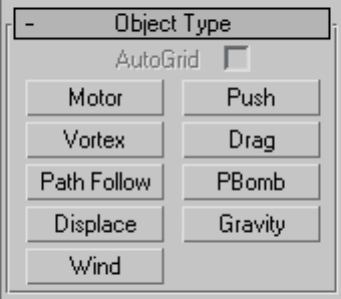
Motor Space Warp on page 2614
Push Space Warp on page 2609
Vortex Space Warp on page 2619
Drag Space Warp on page 2624
Path Follow Space Warp on page 2635
PBomb Space Warp on page 2629
Displace Space Warp on page 2645
Gravity Space Warp on page 2639
Wind Space Warp on page 2642
Deflectors
These space warps are used to deflect particles or to affect dynamics systems.
All of them can be used with particles and with dynamics. The Supports Objects
of Type rollout indicates which systems each space warp supports.
PDynaFlect Space Warp on page 2656
POmniFlect Space Warp on page 2650
SDynaFlect Space Warp on page 2663
SOmniFlect Space Warp on page 2661
UDynaFlect Space Warp on page 2666
UOmniFlect Space Warp on page 2664
SDeflector Space Warp on page 2669
Space Warp Objects | 2607

UDeflector Space Warp on page 2672
Deflector Space Warp on page 2675
Geometric/Deformable
These space warps are used to deform geometry.
FFD(Box) Space Warp on page 2678
FFD(Cyl) Space Warp on page 2685
Wave Space Warp on page 2695
Ripple Space Warp on page 2699
Displace Space Warp on page 2645
Conform Space Warp on page 2703
Bomb Space Warp on page 2707
Modifier-Based
These are space-warp versions of object modifiers (see Modify Panel on page
7425 ). Read more about these in Modifier-Based Space Warps on page 2711 .
Bend Modifier on page 1139
Noise Modifier on page 1501
Skew Modifier on page 1596
Taper Modifier on page 1739
Twist Modifier on page 1765
Stretch Modifier on page 1681
Procedures
To create a space warp:
1 On the Create panel, click Space Warps.
The Space Warps panel is displayed.
2Choose a category of space warp from the list.
3On the Object Type rollout, click a space warp button.
2608 | Chapter 12 Space Warps and Particle Systems
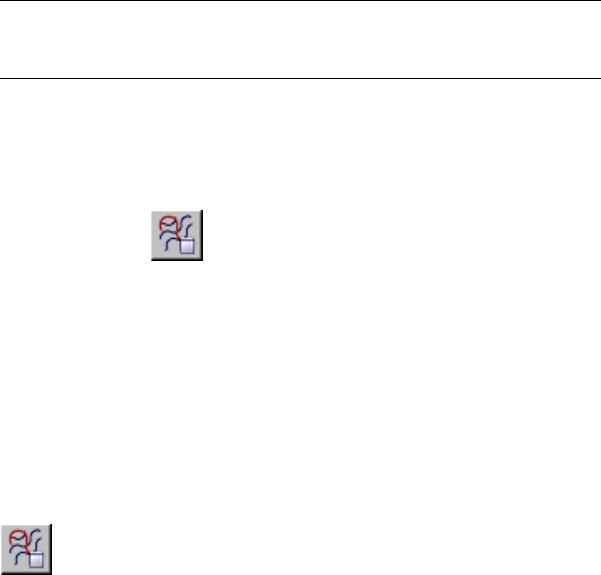
TIP You can take advantage of the AutoGrid feature to orient and position
new space warps with respect to existing objects. For details, see AutoGrid
on page 2513 .
4Drag in a viewport to create the space warp.
See the topics for the various space warps for further details.
Bind to Space Warp
Main toolbar > Bind to Space Warp
Use the Bind to Space Warp button to attach the current selection to a space
warp on page 7934 or vice versa.
Procedures
To bind the current selection to a space warp:
1Select an object
2 Click Bind to Space Warp.
3Drag a line from the selected object to the space warp object. You can
also press H to select the space warp by name.
The space warp object flashes for a moment to show that the bind was
successful.
Forces
Push Space Warp
Create panel > Space Warps > Forces > Object Type rollout > Push
Create menu > Space Warps > Forces > Push
Bind to Space Warp | 2609
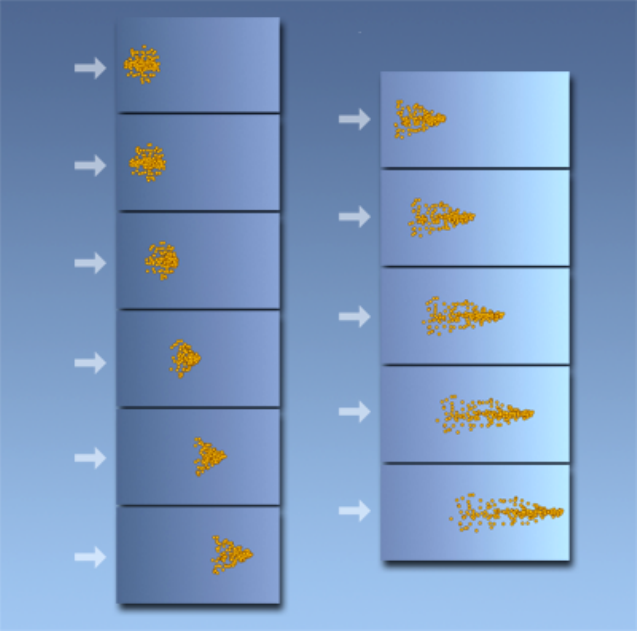
Push disperses a cloud of particles
The Push space warp applies a force to either particle systems on page 2713 or
dynamics systems on page 3775 . The effect is slightly different, depending on
the system.
■Particles: Applies a uniform, unidirectional force in a positive or negative
direction. A positive force moves in the direction of the pad on the
hydraulic jack. The breadth of the force is infinite, perpendicular to the
direction; you can limit it using the Range option.
■Dynamics: Provides a point force (also called a point load) away from the
pad of the hydraulic jack icon. A negative force pulls in the opposite
direction. In dynamics, applying a force is the same as pushing something
with your finger.
2610 | Chapter 12 Space Warps and Particle Systems
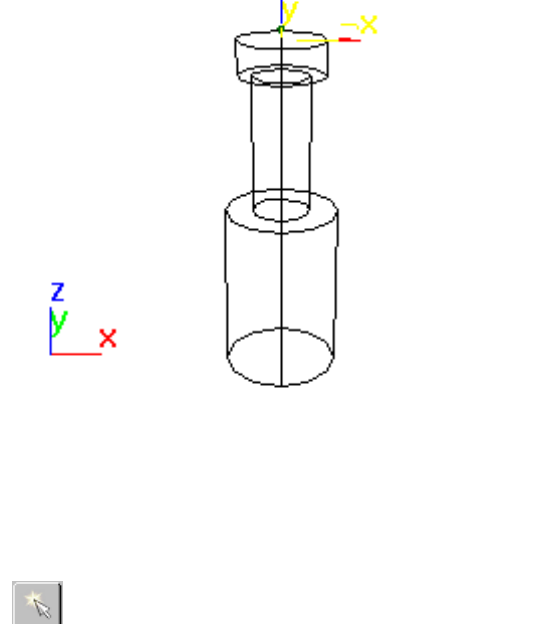
Push viewport icon
Procedures
To create a Push space warp:
1 On the Create panel, click Space Warps. Choose Forces from the
list, and then on the Object Type rollout, click Push.
2Drag in a viewport to define the size.
The Push warp appears as a hydraulic jack icon.
Forces | 2611

Interface
2612 | Chapter 12 Space Warps and Particle Systems

Timing group
On Time/Off Time The numbers of the frames in which the space warp
begins and ends its effect. Because Push moves the particles to which it's
applied over time, no keyframes are created.
Strength Control group
Basic Force The amount of force exerted by the space warp.
Newtons/Pounds This option specifies the units of force used by the Basic
Force spinner.
A pound is about 4.5 Newtons, and one newton is one
kilogram-per-second-squared. When Push is applied to particle systems, these
values have only subjective meaning because they depend on the built-in
weighting factors and time scaling used by the particle system. However, when
used in a dynamics system, the value listed is precisely the value used.
Feedback On When on, the force varies depending on the speed of the
affected particles relative to the specified Target Speed. When off, the force
remains constant, regardless of the speed of the affected particles.
Reversible When on, if the particle's speed exceeds the Target Speed setting,
the force is reversed. Available only if you turn on Feedback On.
Target Speed Specifies the maximum speed in units per frame before the
Feedback takes effect. Available only if you turn on Feedback On.
Gain Specifies how quickly the force adjusts to approaching the target speed.
If set to 100 percent, the correction is immediate. If set lower, a slower and
"looser" response occurs. Available only if you turn on Feedback On.
NOTE Setting Gain above 100 percent can result in over-correction, but is
sometimes necessary to overcome damping from other system settings, such as
IK damping.
Periodic Variation group
These settings introduce variations into the force by affecting the Basic Force
value randomly. You can set two waveforms to produce a noise effect.
Enable Turns on the variations.
Period 1 The time over which the noise variation makes a full cycle. For
example, a setting of 20 means one cycle per 20 frames.
Forces | 2613
Amplitude 1 The strength of the variation (in percent). This option uses the
same types of units as the Basic Force spinner.
Phase 1 Offsets the variation pattern.
Period 2 Provides an additional variation pattern (a second wave) to increase
the noise.
Amplitude 2 The strength of the variation of the second wave (in percent).
This option uses the same types of units as the Basic Force spinner.
Phase 2 Offsets the variation pattern of the second wave.
Particle Effect Range group
Lets you restrict the Push effect's range to a specific volume. This affects particle
systems only; it has no effect on dynamics.
Enable When on, limits the range of the effect to a sphere, displayed as a
tri-hooped sphere. The effect falls off increasingly as the particles near the
boundary of the sphere.
Range Specifies the radius of the range of the effect, in units.
Display Icon group
Icon Size Sets the size of the Push icon. This is for display purposes only,
and does not alter the Push effect.
Motor Space Warp
Create panel > Space Warps > Forces > Object Type rollout > Motor
Create menu > Space Warps > Forces > Motor
2614 | Chapter 12 Space Warps and Particle Systems
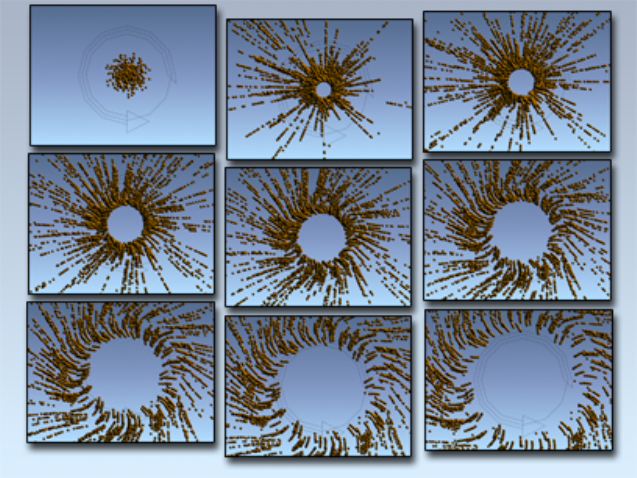
Motor disperses a cloud of particles
The Motor space warp works like Push on page 2609 , but applies rotational
torque to the affected particles or objects rather than a directional force. Both
the position and orientation of the Motor icon affect particles, which swirl
around the Motor icon. When used in dynamics, the position of the icon
relative to the affected object has no effect, but the orientation of the icon
does.
Forces | 2615
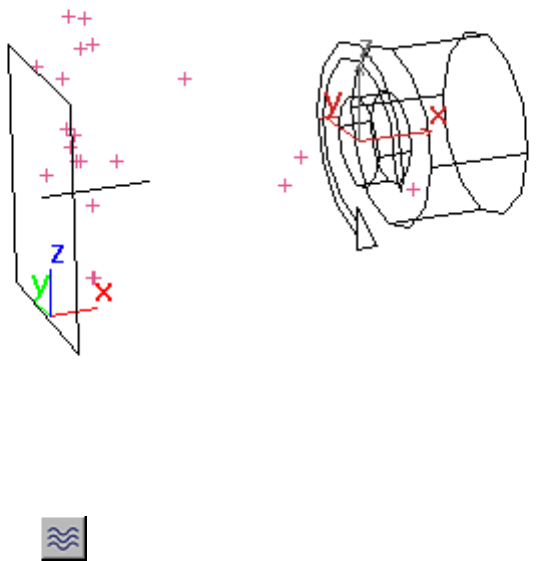
Motor viewport icon (with particle system on the left)
Procedures
To create a motor space warp:
1 On the Create panel, click Space Warps > Forces > Motor. Choose
Forces from the list, then on the Object Type rollout, click Motor.
2Click and drag in a viewport to define the size.
The Motor warp appears as a box-shaped icon with an arrow indicating
the direction of the torque.
2616 | Chapter 12 Space Warps and Particle Systems
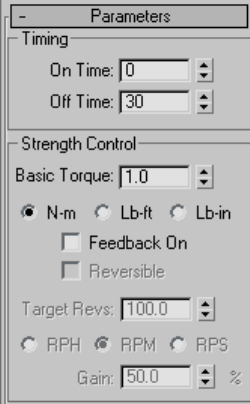
Interface
Timing group
On Time/Off Time The numbers of the frames in which the space warp
begins and ends its effect. Because Motor moves the objects to which it's
applied over time, no keyframes are created.
Strength Control group
Basic Torque The amount of force exerted by the space warp.
N-m/Lb-ft/Lb-in Specify the unit of measure for the Basic Torque setting,
using common world measurements of torque. N-m stands for Newton meters,
Lb-ft stands for pound-force feet, and Lb-in stands for pound-force inches.
Feedback On When on, the force varies depending on the speed of the
affected objects relative to the specified Target Speed. When off, the force
remains constant, regardless of the speed of the affected objects.
Reversible When on, if the object's speed exceeds the Target Speed setting,
the force is reversed. Available only if you turn on Feedback On.
Target Revs Specifies the maximum revolutions before the feedback takes
effect. Speed is specified in units traveled per frame. Available only if you turn
on Feedback On.
Forces | 2617
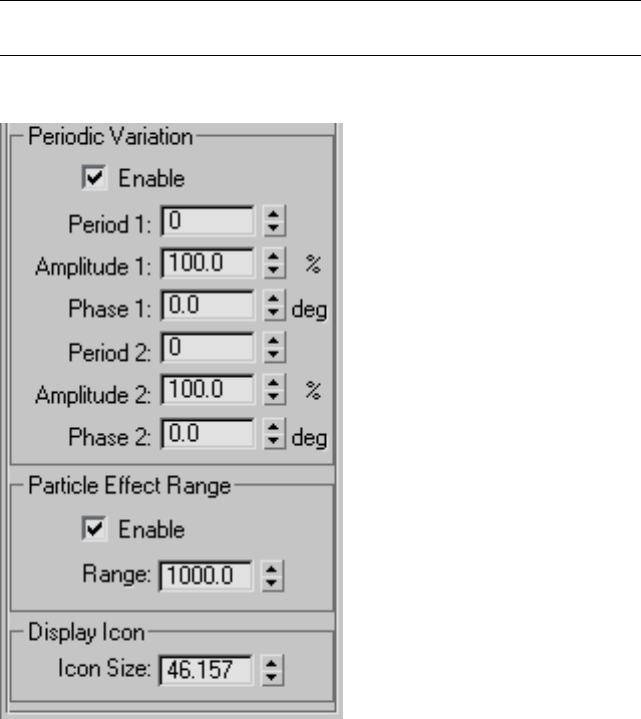
RPH/RPM/RPS Specifies the units of measure for Target Revs in revolutions
per hour, minute, or second. Available only if you turn on Feedback On.
Gain Specifies how quickly the force adjusts to approaching the target speed.
If set to 100%, the correction is immediate. If set lower, a slower and "looser"
response occurs. Available only if you turn on Feedback On.
NOTE Setting Gain above 100% can result in over-correction, but is sometimes
necessary to overcome damping from other system settings, such as IK damping.
Periodic Variation group
These settings introduce variations into the force by affecting the Basic Torque
value randomly. You can set two waveforms to produce a noise effect.
Enable Turn on to enable the variations.
2618 | Chapter 12 Space Warps and Particle Systems
Period 1 The time over which the noise variation makes a full cycle. For
example, a setting of 20 means one cycle per 20 frames.
Amplitude 1 The strength of the variation (in percent). This option uses the
same types of units as the Basic Torque spinner.
Phase 1 Offsets the variation pattern.
Period 2 The next two spinners provide an additional variation pattern to
increase the noise.
Amplitude 2 The strength of the variation of the second wave in (percent).
This option uses the same types of units as the Basic Torque spinner.
Phase 2 Offsets the variation pattern of the second wave.
Particle Effect Range group
Lets you restrict the Motor effect's range to a specific spherical volume. This
affects particles systems only; it has no effect on dynamics.
Enable When on, limits the range of the effect to a sphere, displayed as a
tri-hooped sphere. The effect falls off increasingly as the particles near the
boundary of the sphere.
Range Specifies the radius of the range of the effect, in units.
Display Icon group
Icon Size Sets the size of the Motor icon. This is for display purposes only,
and does not alter the Motor effect.
Vortex Space Warp
Create panel > Space Warps > Forces > Object Type rollout > Vortex
Create menu > Space Warps > Forces > Vortex
The Vortex space warp applies a force to particle systems on page 2713 , spinning
them through a whirling vortex, and then moving them down a long, thin
spout or vortex well. Vortex is useful for creating black holes, whirlpools,
tornadoes, and other funnel-like objects.
The space warp settings let you control the vortex shape, the well
characteristics, and rate and range of particle capture. The shape of the vortex
is also affected by particle system settings, such as speed.
Forces | 2619
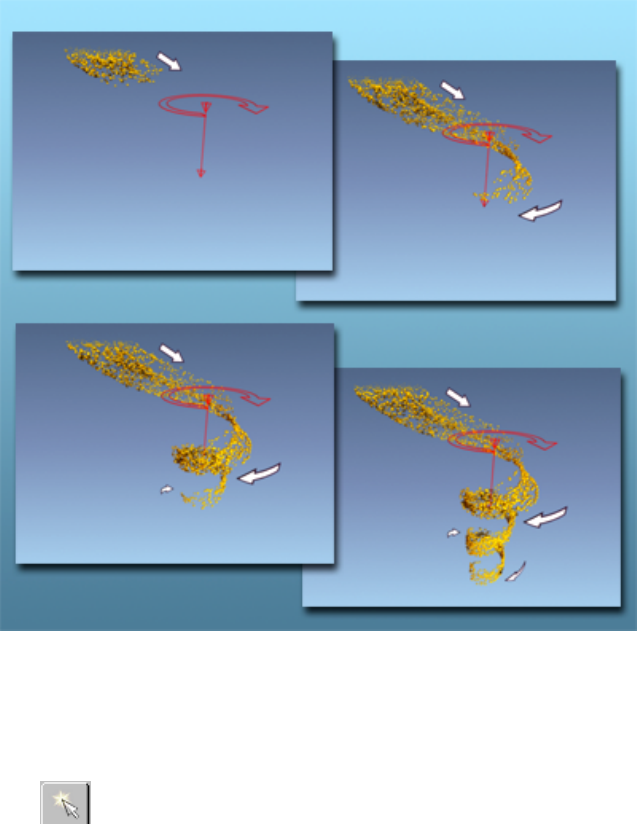
Particle stream caught in a vortex
Procedures
To create a Vortex space warp:
1 On the Create panel, click Space Warps. Choose Forces from the
list, and then click Vortex.
2Determine which world axis you want the vortex to spiral around, and
then drag in the appropriate viewport to create the space warp. For
example, if you want the vortex to spin around the vertical world axis,
create the space warp in the Top viewport. You can rotate the warp later
to change the vortex direction, and animate the warp orientation.
2620 | Chapter 12 Space Warps and Particle Systems

The Vortex warp appears as a curved-arrow icon in the plane you drag
in, with a second, perpendicular arrow indicating the axis of rotation as
well as the direction of the well. This second axis is called the drop axis.
NOTE The position of the space warp plays an important role in the results.
The vertical position affects the shape of the vortex, and the horizontal
position determines its location. If you want the particles to spiral around the
particle emitter, place both at the same location.
Forces | 2621

Interface
Timing group
Time On/Time Off The frame numbers at which the space warp becomes
active and becomes inactive.
2622 | Chapter 12 Space Warps and Particle Systems
Vortex Shape group
Taper Length Controls the length of the vortex, as well as its shape. Lower
settings give you a "tighter" vortex, while higher settings give you a "looser"
vortex. Default=100.0.
Taper Curve Controls the shape of the vortex. Low values create a vortex
with a wide, flared mouth, while high values create a vortex with nearly vertical
sides. Default=1.0. Range=1.0 to 4.0.
Capture and Motion group
This group contains basic settings for Axial Drop, Orbital Speed, and Radial
Pull, with Range, Falloff, and Damping modifiers for each.
Unlimited Range When on, Vortex exerts full damping strength over an
unlimited range. When off, the Range and Falloff settings take effect.
Axial Drop Specifies how quickly particles move in the direction of the drop
axis.
Range The distance from the center of the Vortex icon, in system units, at
which Axial Damping has its full effect. Takes effect only when Unlimited
Range is turned off.
Falloff Specifies the distance beyond the Axial Range within which Axial
Damping is applied. Axial Damping is strongest at the Range distance, decreases
linearly out to the limit of the Axial Falloff, and has no effect beyond that.
Takes effect only when Unlimited Range is turned off.
Damping Controls the degree to which particle motion parallel to the drop
axis is restrained per frame. Default=5.0. Range=0 to 100.
For subtle effects, use values of less than 10%. For more overt effects, try using
higher values that increase to 100% over the course of a few frames.
Orbital Speed Specifies how quickly the particles rotate.
Range The distance from the center of the Vortex icon, in system units, at
which Orbital Damping has its full effect. Takes effect only when Unlimited
Range is turned off.
Falloff Specifies the distance beyond the Orbital Range within which Orbital
Damping is applied. Orbital Damping is strongest at the Range distance,
decreases linearly out to the limit of the Orbital Falloff, and has no effect
beyond that. Takes effect only when Unlimited Range is turned off.
Forces | 2623

Damping Controls the degree to which orbital particle motion is restrained
per frame. Smaller values produce a wide spiral, while larger values produce
a thin spiral. Default=5.0. Range=0 to 100.
Radial Pull Specifies the distance from the drop axis at which the particles
rotate.
Range The distance from the center of the Vortex icon, in system units, at
which Radial Damping has its full effect. Takes effect only when Unlimited
Range is turned off.
Falloff Specifies the distance beyond the Radial Range within which Radial
Damping is applied. Radial Damping is strongest at the Range distance,
decreases linearly out to the limit of the Radial Falloff, and has no effect beyond
that. Takes effect only when Unlimited Range is turned off.
Damping Controls the degree to which Radial Pull is restrained per frame.
Default=5.0. Range=0 to 100.
CW/CCW Determines whether particles rotate clockwise or counterclockwise.
Display group
Icon Size Specifies the size of the icon.
Drag Space Warp
Create panel > Space Warps > Forces > Object Type rollout > Drag
Create menu > Space Warps > Forces > Drag
The Drag space warp is a particle motion damper that reduces particle velocity
by a specified amount within a specified range. The damping can be applied
linearly, spherically, or cylindrically. Drag is useful for simulating wind
resistance, transfers into dense media (like water), impacts with force fields,
and other, similar situations.
With each damping type, you can control the damping effect along several
vectors. The damping is also affected by particle system settings, such as speed.
NOTE To create a uniform drag effect, the default value for all directional
parameters is 5.0%.
2624 | Chapter 12 Space Warps and Particle Systems
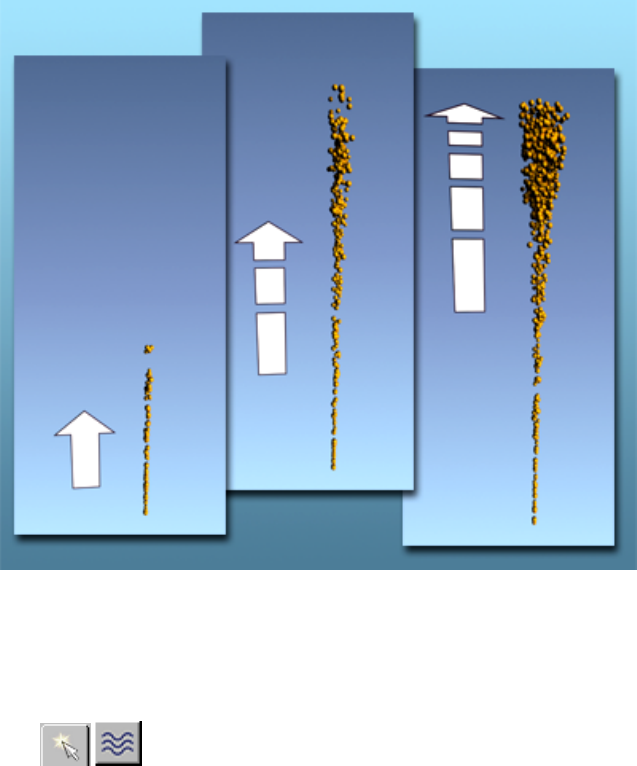
Drag slows down a stream of particles.
Procedures
To create a Drag space warp:
1 On the Create panel, click Space Warps. Choose Forces from
the list, and then click Drag.
2Drag in a viewport to create the space warp.
The space warp appears initially as a box within a box, indicating that
it's using the default Linear Damping mode.
3To apply the damping spherically or cylindrically, choose Spherical
Damping or Cylindrical Damping in the command panel.
Forces | 2625

NOTE The position and orientation of the space warp plays an important
role for all three damping types.
4Change the settings for the current damping type as necessary.
2626 | Chapter 12 Space Warps and Particle Systems

Interface
Forces | 2627
Timing group
Time On/Time Off The frame numbers at which the space warp becomes
active and becomes inactive.
Damping Characteristics group
This group lets you choose Linear Damping, Spherical Damping, or Cylindrical
Damping, plus a set of parameters for each.
Unlimited Range When on, Drag exerts full damping strength over an
unlimited range. When off, the Range and Falloff settings for the current
damping type take effect.
■Linear Damping Motion for each particle is separated into vectors for
the space warp's local X, Y, and Z axes. The area over which damping is
exerted for each vector is an infinite plane whose thickness is determined
by the corresponding Range setting.
X Axis/Y Axis/Z Axis Specifies the percentage of particle motion along
the local Drag space warp axis that's affected by the damping.
Range Sets the thickness of the "range plane," or the infinite plane
perpendicular to the specified axis. Takes effect only when Unlimited Range
is turned off.
Falloff Specifies the distance beyond the X, Y, or Z Range within which
Linear Damping is applied. Damping is strongest at the Range distance,
decreases linearly out to the limit of the Falloff, and has no effect beyond
that. While Falloff takes effect only beyond the Range, it is measured from
the center of the icon, and always has a minimum value equal to the Range
value. Takes effect only when Unlimited Range is turned off.
■Spherical Damping When Drag operates in Spherical Damping mode,
its icon is a sphere within a sphere. Particle motion is broken up into radial
and tangential vectors. Damping is applied for each vector within a
spherical volume whose radius is set by the Range setting, when Unlimited
Range is off.
Radial/Tangential Radial specifies the percentage of particle motion
toward or away from the center of the Drag icon that's affected by the
damping. Tangential specifies the percentage of particle motion across the
body of the Drag icon that's affected by the damping.
Range Specifies the distance from the center of the Drag icon, in system
units, within which damping is in full effect. Takes effect only when
Unlimited Range is turned off.
2628 | Chapter 12 Space Warps and Particle Systems
Falloff Specifies the distance beyond the Radial/Tangential Range within
which Linear Damping is applied. Damping is strongest at the Range
distance, decreases linearly out to the limit of the Falloff, and has no effect
beyond that. While Falloff takes effect only beyond the Range, it is
measured from the center of the icon, and always has a minimum value
equal to the Range value. Takes effect only when Unlimited Range is turned
off.
■Cylindrical Damping When Drag operates in Spherical Cylindrical mode,
its icon is a cylinder within a cylinder. Particle motion is broken up into
radial, tangential, and axial vectors. Damping is applied within a spherical
volume for the radial and tangential vectors and on a planar basis for the
axial vector.
Radial/Tangential/Axial Damping controls the percentage of particle
motion toward or away from the center of the circular portion of the icon
(Radial), across the radial vector (Tangential), or along the length of the
icon's long axis (Axial) that's affected by the damping, on a per-frame basis.
Range Specifies the distance from the center of the Drag icon, in system
units, within which Radial and Axial damping are in full effect. Range also
specifies the thickness of the infinite plane that governs the range of Axial
damping. Takes effect only when Unlimited Range is turned off.
Falloff Specifies the distance beyond the Radial/Tangential/Axial Range
within which Linear Damping is applied. Damping is strongest at the Range
distance, decreases linearly out to the limit of the Falloff, and has no effect
beyond that. While Falloff takes effect only beyond the Range, it is
measured from the center of the icon, and always has a minimum value
equal to the Range value. Takes effect only when Unlimited Range is turned
off.
Display group
Icon Size Specifies the size of the icon.
PBomb Space Warp
Create panel > Space Warps > Forces > Object Type rollout > PBomb
Create menu > Space Warps > Forces > PBomb
The PBomb space warp creates an impulse wave to blow up a particle system,
as distinguished from the Bomb space warp on page 2707 , which blows up
geometry. The PBomb is particularly well suited to the Particle Array (PArray)
Forces | 2629
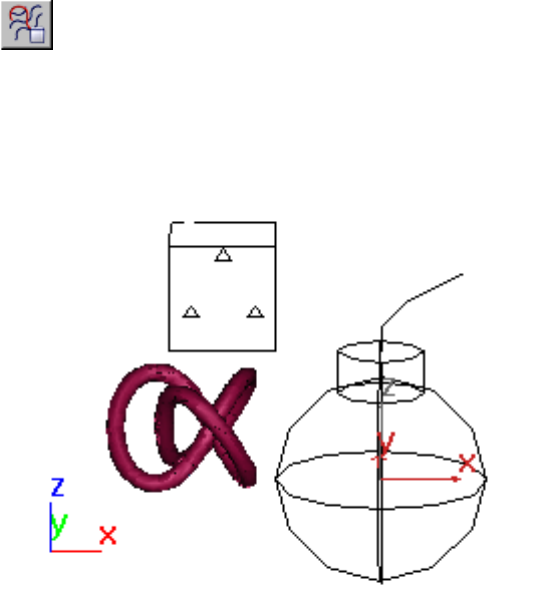
system with Particle Types set to Object Fragments. This space warp also applies
an impulse as a dynamics effect.
The general usage is as follows:
■Create a particle system (recommended: a PArray system on page 2964 set
to Object Fragments).
■ Create a PBomb and use Bind to Space Warp on page 2609 to bind
it to a non-event-driven particle system. Be sure to bind the PBomb to the
particle system and not to the distribution object. Or, if using Particle Flow,
use a Force operator on page 2867 to apply the space warp to the particle
system.
■Adjust the parameters of both the PBomb and the particle system.
Right: PBomb viewport icon
Above: PArray particle system
Below: Torus knot used as the PArray's distribution object
2630 | Chapter 12 Space Warps and Particle Systems
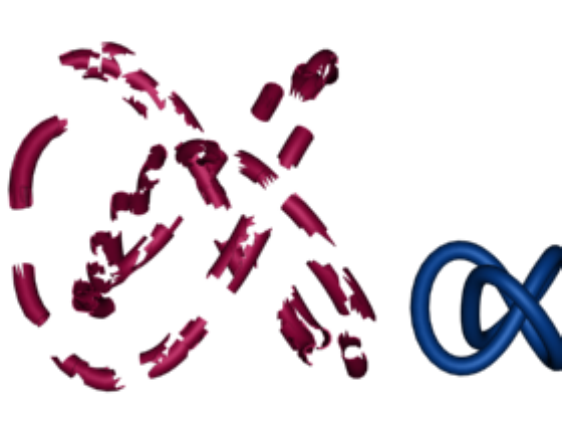
Effect of blowing up the torus knot
Procedures
Example: To use PBomb with PArray:
You can use the Particle Bomb bound to a Particle Array to blow an object
into fragments. The following steps demonstrate the basic setup.
Begin by binding a particle array to an object, and setting parameters.
1Create the object you want to blow up.
2Create a PArray and use Pick Object to assign the object to blow up as
the PArray object-based emitter.
3In the Basic Parameters rollout > Viewport Display group, choose Mesh
to display the fragments as mesh objects in the viewports.
4On the Particle Generation rollout of PArray, set Speed and Divergence
to 0.0. This prevents PArray from moving the particles, letting PBomb
do the work.
5On the Particle Generation rollout, set Life to the length of the active
time segment, so that the fragments appear during the entire animation.
Forces | 2631
6In the Particle Type rollout > Particle Types group, choose Object
Fragments. In the Object Fragment Controls group, choose Number of
Chunks, and set the Minimum to about 50, depending on your
distribution object and the effect you want.
Now create a particle bomb, and bind it to the particle array.
1In the Space Warps panel > Particles & Dynamics category, click the
PBomb button and drag in a viewport to create the PBomb icon.
2Use Bind to Space Warp to bind the PArray icon to the PBomb icon.
(Don't bind the distribution object by mistake.)
3Select the PBomb icon and move to the Modify panel.
4In the Explosion Parameters group, set Blast Symmetry to Spherical, Start
Time to 10, Duration to 1, and Strength to 1.0. Choose Linear, if it's not
already chosen.
5Drag the time slider between frames 9 and 20 to see the effect.
6Go to frame 12 and try out various settings. Notice that increasing
Strength expands the explosion effect at the current frame. If you decrease
Range enough, the bomb no longer affects all or part of the object
(depending on the placement of the PBomb icon). Test the three Blast
Symmetry settings by placing the bomb in the center of the object and
then seeing the different blast patterns.
Once you get an explosive effect you like, you can return to the PArray settings,
add spin or thickness to the fragments, and so on.
2632 | Chapter 12 Space Warps and Particle Systems
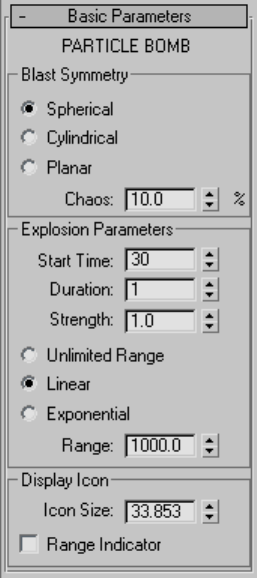
Interface
Blast Symmetry group
These options specify the shape, or pattern of the blast effect.
Spherical The blast force radiates outward from the PBomb icon in all
directions. The icon looks like a spherical anarchist's bomb.
Cylindrical The blast force radiates outward from and normal to the central
axis, or core of the cylindrical icon. The icon looks like a stick of dynamite
with a fuse.
Planar The blast force radiates both up and down, perpendicular to the plane
of the planar icon. The icon looks like a plane with arrows pointing up and
down along the direction of the blast force.
Chaos The blast forces vary for each particle or each frame, an effect similar
to Brownian motion, with a rate of change in the direction of force equal to
Forces | 2633
the rendering interval rate. Note: This setting is effective only when the
Duration spinner is set to 0.
Explosion Parameters group
Start Time The frame number at which the impulse forces are first applied
to the particles.
Duration The number of frames, beyond the first, over which the forces are
applied. This value should typically be a small number, such as between 0 and
3.
Strength The change in velocity along the blast vector, in units per frame.
Increasing Strength increases the speed with which the particles are blown
away from the bomb icon.
Unlimited Range The effects of the bomb icon reach all bound particles
throughout the scene. This option ignores the Range setting (which specifies
the distance of the PBomb effect).
Linear The impulse forces decay linearly between the full Strength setting
to a value of 0 at the specified Range setting.
Exponential The impulse forces decay exponentially between the full Strength
setting to a value of 0 at the specified Range setting.
Range The maximum distance, in units, over which the PBomb icon affects
the bound particle system. If the Range is large enough to reach only a portion
of the particle system, only that part of the system is affected.
If you turn on Range Indicator (see following), the extent of the range is
indicated by a tri-hooped sphere. If you choose Unlimited Range, this
parameter has no effect.
Display Icon group
These options affect the visual display of the PBomb icon.
Icon Size Alters the overall size of the PBomb icon.
Range Indicator Displays a wireframe sphere that indicates the volume of
the particle bomb's influence. If you choose Unlimited Range, turning this
on has no effect.
2634 | Chapter 12 Space Warps and Particle Systems
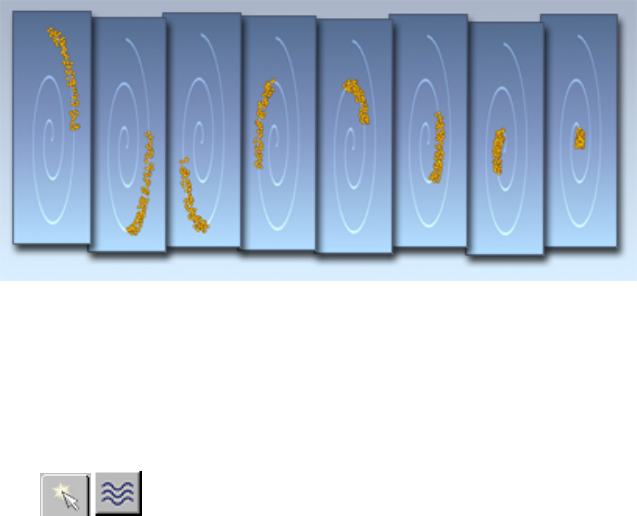
Path Follow Space Warp
Create panel > Space Warps > Forces > Object Type rollout > Path Follow
Create menu > Space Warps > Forces > Path Follow
Particles following a spiral path
The Path Follow space warp forces particles to follow a spline path.
Procedures
To create a Path Follow space warp:
1 On the Create panel, click Space Warps. Choose Forces from
the list, then on the Object Type rollout, click Path Follow.
2Click and drag in a viewport to define the size.
The Path Follow warp appears as a box-shaped icon containing curved
lines that indicate hypothetical paths.
To set up and use Path Follow:
1Create a shape consisting of a single spline. (You can use shapes with
multiple splines, but the software uses only one spline for the path.)
2Create a particle system and set its parameters to emit particles over a
range of frames.
Forces | 2635
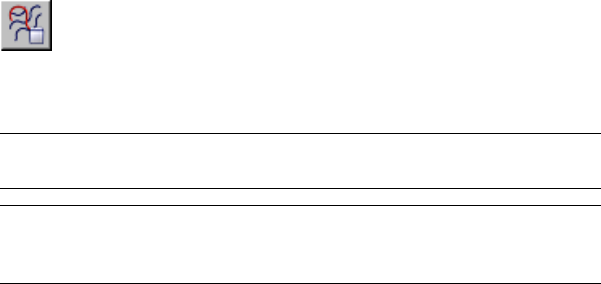
3On the Create panel, click Path Follow, and drag in a viewport to create
the Path Follow icon (a cube with wavy lines). The display and position
of this icon don't affect the particles.
4On the Basic Parameters rollout, click Pick Shape Object and select the
spline you created earlier.
5 Bind the Path Follow icon to the particle system.
6Adjust the Path Follow parameters to create the particle movement you
want.
NOTE You can further animate the particle effect by animating the spline
vertices.
TIP To adjust the position of the path or particle system while maintaining
access to the Path Follow parameters, turn on Modifier Stack rollout > Pin
Stack while the Path Follow space warp is selected.
If the particles don't follow the emitter after it's moved, then change any
PathFollow parameter, and the motion will be corrected.
2636 | Chapter 12 Space Warps and Particle Systems

Interface
Forces | 2637
Current Path group
Lets you choose the path for the particles, and specify the range of influence
of the Space Warp.
Object Displays the name of the currently assigned path.
Pick Shape Object Click this, and then click a shape in the scene to select it
as a path. You can use any shape object as a path; if you select a multiple-spline
shape, only one the lowest-number spline is used. You can also use NURBS
curves as paths.
Unlimited Range When off, the range of influence of the space warp is
limited to the value set in the Distance spinner. When on, the space warp
influences all bound particles in the scene, regardless of their distance from
the path object.
Range Specifies the range of influence when Unlimited Range is off. This is
the distance between the path object and the particle system. The position of
the Path Follow space warp's icon is ignored.
Motion Timing group
These controls affect how long particles are influenced by Path Follow.
Start Frame The frame at which Path Follow begins to influence the particles.
Travel Time The time each particle takes to traverse the path.
Variation The amount by which each particle's travel time can vary.
Last Frame The frame at which Path Follow releases the particles and no
longer influences them.
Particle Motion group
The controls in this area determine the motion of particles.
Along Offset Splines The distance between the particle system and the path
alter the effect of the particle motion. If the first vertex of the spline is at the
birthplace of the particle, the particle follows the spline path. If you move the
path away from the particle system, the particles are affected by the offset.
Along Parallel Splines Particles follow a copy of the selected path, parallel
to the particle system. In this mode, the position of the path relative to the
particle system does not matter. The orientation of the path, however, affects
the particle stream.
Constant Speed When on, all particles travel at the same speed.
2638 | Chapter 12 Space Warps and Particle Systems
Stream Taper Causes particles to converge or diverge toward the path over
time, or to simultaneously converge and diverge. You specify the effect by
choosing Converge, Diverge, or Both (see following). This provides a tapering
effect over the length of the path.
Variation The amount by which Stream Taper can vary for each particle.
Converge When Stream Taper is greater than 0, the particles move in toward
the path as they follow the path. The effect is that the stream tapers from
larger to smaller over time.
Diverge Provides the opposite effect of Converge. The particles diverge from
the path over time.
Both Splits the particle stream, causing some particles to converge and others
to diverge.
Stream Swirl Specifies the number of turns by which particles spiral about
the path. In conjunction with Stream Taper, alters the diameter of the spiral.
Stream Swirl is generally more effective when you choose Along Offset Splines.
Variation The amount by which each particle can vary from the Spiral value.
Clockwise Particles spiral in a clockwise direction.
Counterclockwise Particles spiral in a counterclockwise direction.
Bidirectional The stream is split so that particles spiral in both directions.
Uniqueness group
Provides a seed number for unique generation of the particle pattern.
Seed Specifies the seed number for the current Path Follow.
Display Icon group
Affects the display of the Path Follow icon.
Icon Size Specifies the size of the Path Follow icon. Does not alter the Path
Follow effect.
Gravity Space Warp
Create panel > Space Warps > Forces > Object Type rollout > Gravity
Create menu > Space Warps > Forces > Gravity
Forces | 2639
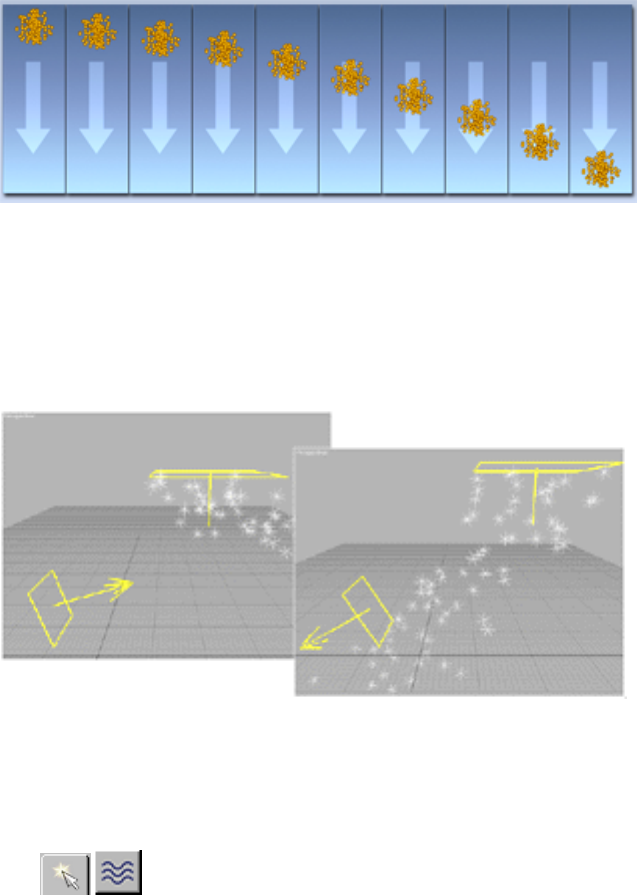
Particles falling because of gravity
The Gravity space warp simulates the effect of natural gravity on particles
generated by a particle system. Gravity is directional. Particles moving in the
direction of the gravity arrow accelerate. Particles moving against the arrow
decelerate. In the case of spherical gravity, motion is toward the icon. Gravity
can also be used as an effect in dynamics simulations. See Dynamics Utility
on page 3775 .
Gravity effect on snow
Procedures
To create gravity:
1 On the Create panel, click Space Warps. Choose Forces from
the list, then on the Object Type rollout, click Gravity.
2Drag in a viewport.
2640 | Chapter 12 Space Warps and Particle Systems
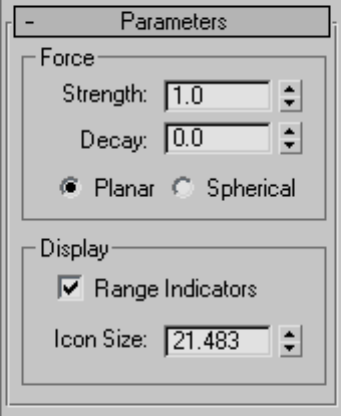
The Gravity icon appears. For planar gravity (the default), the icon is a
wireframe square with a direction arrow on one side. For spherical gravity,
the icon is a wireframe sphere.
The initial direction of planar gravity is along the negative Z axis of the
construction grid that is active in the viewport where you drag. You can
rotate the gravity object to change the direction.
Interface
Force group
Strength Increasing Strength increases the effect of gravity; that is, how
objects move in relation to the Gravity icon's direction arrow. Strength less
than 0.0 creates negative gravity, which repels particles moving in the same
direction and attracts particles moving in the opposite direction. When
Strength is set to 0.0, the Gravity space warp has no effect.
Decay When Decay is set to 0.0, the Gravity space warp has the same strength
throughout world space. Increasing the Decay value causes gravity strength
to diminish as distance increases from the position of the gravity warp object.
Default=0.0.
Planar Gravity effect is perpendicular to the plane of the Gravity warp object
throughout the scene.
Forces | 2641
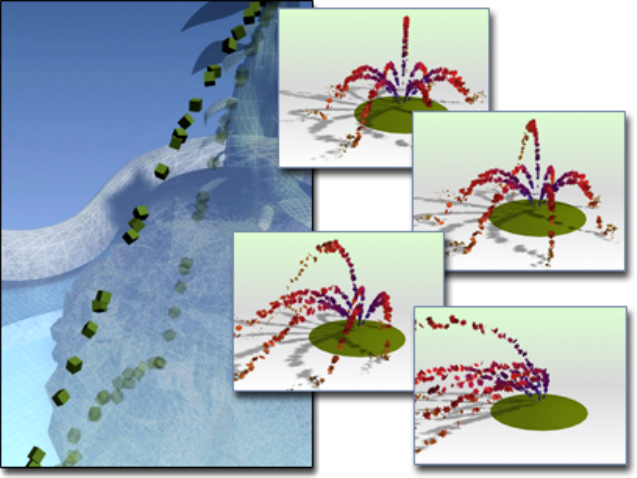
Spherical Gravity effect is spherical, centered on the Gravity warp object.
This choice is effective for creating water fountain or planetary effects.
Display group
Range Indicators When on, and when the Decay value is greater than 0.0,
icons in the viewports indicate the range at which the force of gravity is half
the maximum value. For the Planar option, the indicators are two planes; for
use the Spherical option, the indicator is a double-hooped sphere.
Icon Size Size of the Gravity warp object icon, in active units. You set the
initial size when you drag to create the Gravity object. This value does not
change the gravity effect.
Wind Space Warp
Create panel > Space Warps > Forces > Object Type rollout > Wind
Create menu > Space Warps > Forces > Wind
Wind changing the direction of the spray of a fountain
2642 | Chapter 12 Space Warps and Particle Systems
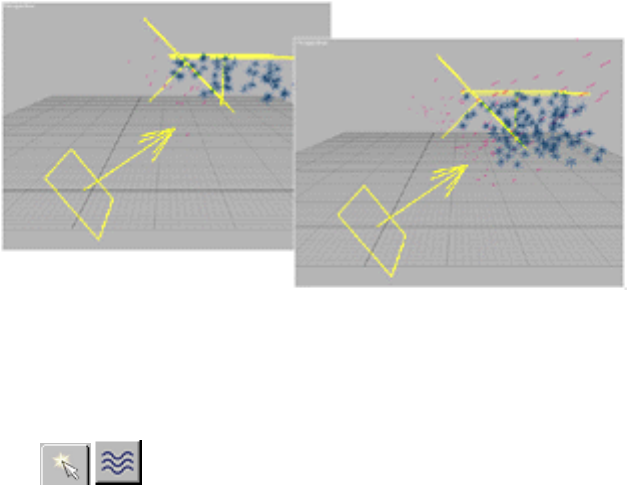
The Wind space warp simulates the effect of wind blowing particles generated
by a particle system. Wind is directional. Particles moving in the direction of
the wind arrow accelerate. Particles moving against the arrow decelerate. In
the case of spherical wind, motion is toward or away from the icon. Wind is
similar in effect to the Gravity space warp, but has added parameters for
turbulence and other features characteristic of wind in the natural world.
Wind can also be used as an effect in dynamics simulations. See Dynamics
Utility on page 3775 .
Wind effect on snow and spray
Procedures
To create wind:
1 On the Create panel, click Space Warps. Choose Forces from
the list, then on the Object Type rollout, click Wind.
2Drag in a viewport.
The wind icon appears. For planar wind (the default), the icon is a
wireframe square with a direction arrow coming out of one side. For
spherical wind, the icon is a wireframe sphere.
The initial direction of planar wind is along the negative Z axis of the
construction grid that is active in the viewport where you drag. You can
rotate the wind object to change the direction.
Forces | 2643
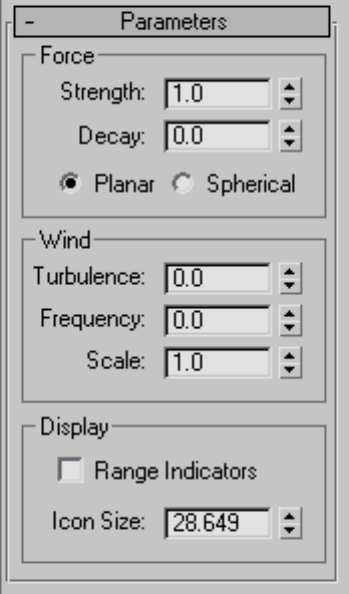
Interface
Force group
These settings are comparable to the Gravity parameters.
Strength Increasing Strength increases the wind effect. Strength less than
0.0 creates a suction. It repels particles moving in the same direction and
attracts particles moving in the opposite direction. When Strength is 0.0, the
Wind warp has no effect.
Decay When Decay is set to 0.0, the Wind warp has the same strength
throughout world space. Increasing the Decay value causes wind strength to
diminish as distance increases from the position of the Wind warp object.
Default=0.0.
Planar Wind effect is perpendicular to the plane of the Wind warp object,
throughout the scene.
2644 | Chapter 12 Space Warps and Particle Systems
Spherical Wind effect is spherical, centered on the Wind warp object.
Wind group
These settings are specific to the Wind space warp.
Turbulence Causes particles to change course randomly as the wind blows
them. The greater the value, the greater the turbulence effect.
Frequency When set greater than 0.0, causes turbulence to vary periodically
over time. This subtle effect is probably not visible unless your bound particle
system generates a large number of particles.
Scale Scales the turbulence effect. When Scale is small, turbulence is smoother
and more regular. As Scale increases, turbulence grows more irregular and
wild.
Display group
Range Indicators When the Decay value is greater than zero, icons appear
in the viewports that represent the range at which the force of wind is half
the maximum value. When you use the Planar option, the indicators are two
planes; when you use the Spherical option, the indicator is a double-hooped
sphere.
Icon Size Size of the Wind warp object icon, in active units. You set the
initial Icon Size value when you drag to create the wind object. This value
does not change the wind effect.
Displace Space Warp
Create panel > Space Warps > Geometric/Deformable > Object Type rollout >
Displace
Create menu > Space Warps > Geometric/Deformable > Displace
Forces | 2645
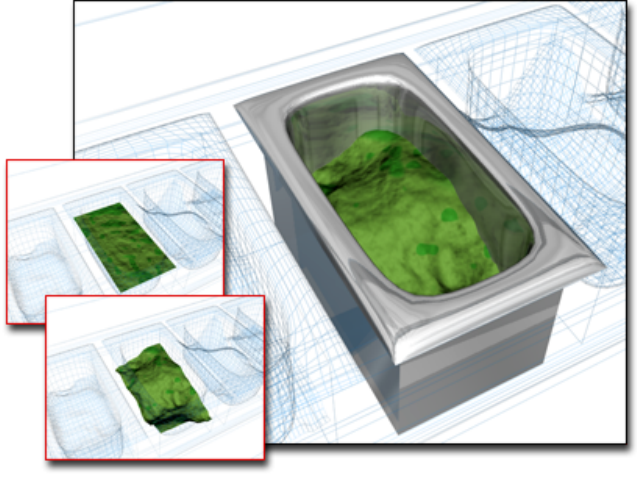
Displace used to change the surface in the container
The Displace space warp acts as a force field to push and reshape an object's
geometry. Displace affects both geometry (deformable objects) and particle
systems. There are two basic ways to use the Displace space warp:
■Apply the gray scale of a bitmap to generate the displacement amount.
Black areas of the 2D image are not displaced. Whiter areas push outward,
causing a 3D displacement of geometry.
■Apply displacement directly by setting displacement Strength and Decay
values.
The Displace space warp works similarly to the Displace modifier, except that,
like all space warps, it affects world space rather than object space. Use the
Displace modifier when you need to create detailed displacement of a small
number of objects. Use the Displace space warp to displace particle systems,
a large number of geometric objects at once, or an object relative to its position
in world space.
For geometry, the detail of the displacement depends on the number of
vertices. Use the Tessellate modifier to tessellate faces you want to show in
greater detail.
2646 | Chapter 12 Space Warps and Particle Systems
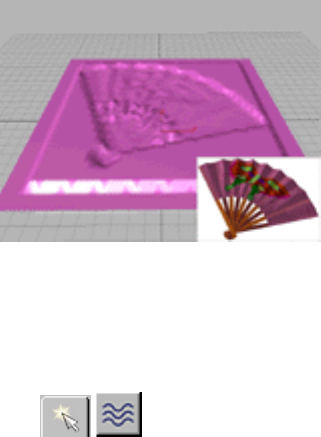
Displace space warp on a patch and the bitmap it uses
Procedures
To create a Displace space warp:
1 On the Create panel, click Space Warps. Choose
Geometric/Deformable from the list, and then on the Object Type rollout,
click Displace.
2Drag in a viewport to create the Displace warp object, which appears as
a wireframe. Its shape depends on the active mapping parameter settings.
Regardless of the mapping, a single drag creates the space warp.
3Bind the space warp to an appropriate object.
To assign a bitmap to a displace space warp:
1Select the Displace warp object.
2In the Parameters rollout > Displacement group, click the Bitmap button
(labeled "None" by default). Use the selection dialog to choose a bitmap.
3Set the Strength value. Vary the strength of the field to see how the bitmap
displaces the object's geometry.
Forces | 2647

Interface
Displacement group
These are the basic controls for Displace space warps.
2648 | Chapter 12 Space Warps and Particle Systems
Strength When set to 0.0, the Displace warp has no effect. Values greater
than 0.0 displace object geometry or particles away from the position of the
Displace space warp object. Values less than 0.0 displace geometry toward the
warp. Default=0.0
Decay By default, the Displace warp has the same strength throughout world
space. Increasing Decay causes displacement strength to diminish as distance
increases from the position of the Displace warp object. Default=0.0
Luminance Center By default, the Displace space warp centers the luminance
by using medium (50%) gray as the zero displacement value. Gray values
greater than 128 displace in the outward direction (away from the Displace
warp object) and gray values less than 128 displace in the inward direction
(toward the Displace warp object). You can adjust the default using the Center
spinner. With a Planar projection, the displaced geometry is repositioned
above or below the Planar gizmo. Default=0.5. Range=0 to 1.0.
Image group
These options let you choose a bitmap and map to use for displacement.
Bitmap (Labeled "None" by default.) Click to assign a bitmap or map from
a selection dialog. After you choose a bitmap or map, this button displays the
bitmap's name.
Remove Bitmap Click to remove the bitmap or map assignment.
Blur Increase this value to blur or soften the effect of the bitmapped
displacement.
Map group
This area contains mapping parameters for a bitmapped Displace warp. The
mapping options are comparable to those options used with mapped materials.
The four mapping modes control how the Displace warp object projects its
displacement. The warp object's orientation controls where in the scene the
displacement effect will appear on bound objects.
Planar Projects the map from a single plane.
Cylindrical Projects the map as if it were wrapped around the cylinder.
Spherical Projects the map from a sphere, with singularities at the top and
bottom of the sphere, where the bitmap edges meet at the sphere's poles.
Shrink Wrap Truncates the corners of the map and joins them all at a single
pole, creating one singularity.
Forces | 2649
Length, Width, Height Specify the dimensions of the bounding box of the
space warp gizmo. Height has no effect on planar mapping.
U/V/W Tile The number of times the bitmap repeats along the specified
dimension. The default value of 1.0 maps the bitmap once; a value of 2.0 maps
the bitmap twice, and so on. Fractional values map a fractional portion of the
bitmap in addition to copies of the whole map. For example, a value of 2.5
maps the bitmap two and one-half times.
Flip Reverses the orientation of the map along the corresponding U, V, or
W axis.
Deflectors
POmniFlect Space Warp
Create panel > Space Warps > Deflectors > Object Type rollout > POmniFlect
POmniFlect is a planar version of the omniflector type of space warp. It
provides enhanced functionality over that found in the original Deflector
space warp, including refraction and spawning capabilities.
2650 | Chapter 12 Space Warps and Particle Systems
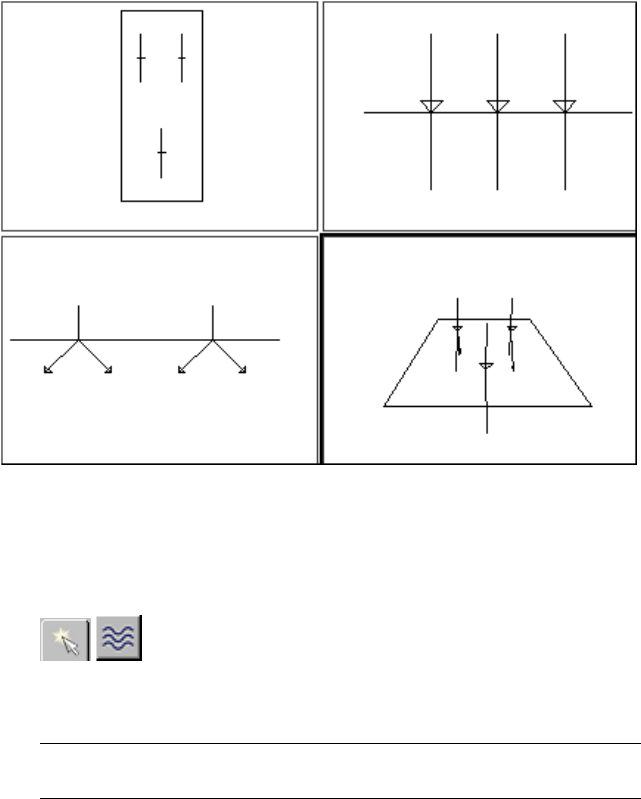
POmniFlect viewport icon
Procedures
To create a POmniFlect space warp:
1 On the Create panel, click Space Warps. Choose Deflectors
from the list, then on the Object Type rollout, click POmniFlect.
2Drag in a viewport to create the planar icon.
NOTE Because particles bounce off the icon, the size of the icon affects
particle deflection.
Deflectors | 2651

3Apply the deflector to the particle system using the appropriate method:
■If using Particle Flow on page 2713 , specify the deflector in the
Collision test on page 2881 or Collision Spawn test on page 2885
parameters.
■ If using a non-event-driven particle system on page 2923 , bind
on page 2609 the particle system to the deflector icon.
4Position the POmniFlect icon to interrupt the particle stream.
5Adjust the POmniFlect parameters as necessary.
2652 | Chapter 12 Space Warps and Particle Systems

Interface
Deflectors | 2653

Timing group
The two spinners specify the start frame and end frame of the deflection effect.
Time On/Off Time On specifies the frame at which the deflection begins,
and Time Off specifies the frame at which the deflection ends.
Reflection group
These options affect the reflection of particles from the space warp. The
POmniFlect can reflect or refract particles, or perform a combination of the
two.
Reflects Specifies the percentage of particles to be reflected by the
POmniFlect. See also Refracts, later in this topic, for methods of combining
the two effects.
Bounce This is a multiplier that specifies how much of the initial speed of
the particle is maintained after collision with the POmniFlect. Using the default
setting of 1.0 causes the particle to rebound with the same speed as it collides.
A real-world effect would usually be less than 1.0. For a “flubber” effect, set
greater than 1.0.
Variation Specifies the variation of Bounce applied to the range of particles.
For example, a Variation of 50% applied to a Bounce setting of 1.0 would
result in randomly applied Bounce values ranging from 0.5 to 1.5.
Chaos Applies a random variation to the bounce angle. When set to 0.0 (no
chaos), all particles bounce off the POmniFlect surface perfectly (like banking
pool balls). A non-zero setting causes the deflected particles to scatter.
Refraction group
These settings are similar to those in the Reflection group, but these affect the
refraction of particles as they pass through the POmniFlect, causing the direction
of the particles to change.
Refracts Specifies the percentage of particles not already reflected that will be
refracted by the POmniFlect.
NOTE The Refracts value affects only those particles not already reflected because
the reflected particles are processed before the refracted particles. Thus, if you set
Reflects to 50% and Refracts to 50%, you would not get a 50/50 split of particles.
Rather, half the particles would be reflected, and then half the remainder (25%
of the total) would be refracted. The remaining particles either pass through
without being refracted or are passed on to Spawn Effects.
2654 | Chapter 12 Space Warps and Particle Systems
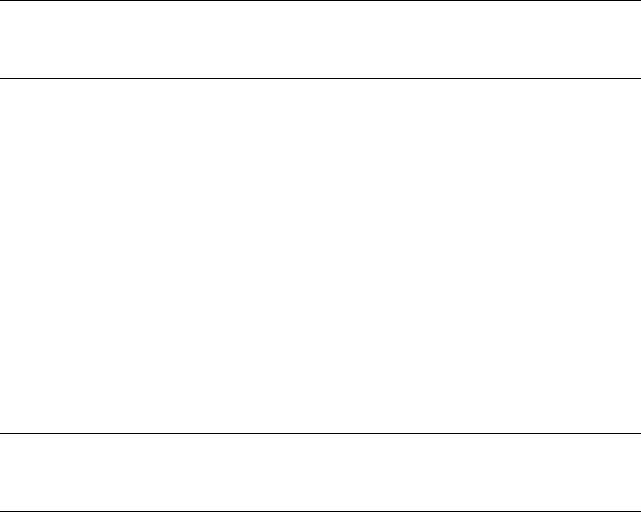
To get a 50/50 split of reflection and refraction, set Reflects to 50% and Refracts
to 100%.
Pass Vel Specifies how much of a particle’s initial speed is maintained after
passing through the POmniFlect. The default setting of 1 retains the initial
speed is retained, so there’s no change. A setting of 0.5 reduces the speed by
half.
Variation Specifies the variation of Pass Velocity applied to the range of
particles.
Distortion Controls the angle of refraction. A value of 0 means there’s no
refraction. A value of 100% sets the angle of the particles to be parallel with
the POmniFlect surface. A value of −100% sets the angle perpendicular to the
surface. The Distortion effect is reversed when particles strike the POmniFlect
from the back side.
NOTE Distortion and Refraction do not work properly when particles strike the
POmniFlect surface at exactly 90 degrees. In this case, any positive Distortion
settings cause a scattering of particles, while negative values have no effect.
Variation Specifies a range of variation of the Distortion effect.
Diffusion Applies a diffusion effect to the refraction by randomly modifying
each particle’s Distortion angle by the Diffusion angle. This effectively scatters
the particles into a hollow cone.
Variation Specifies a range of variation of the Diffusion value.
Common group
Friction The amount by which particles are slowed as they move along the
deflector surface. A value of 0% means they're not slowed at all. A value of
50% means they're slowed to half their original speed. A value of 100% means
they stop moving when they strike the surface. Default=0%. Range=0% to
100%.
TIP To have particles slide along a deflector surface, set Bounce to 0. Also, unless
influenced by a force such as Wind or Gravity, particles meant to slide should strike
the surface at an angle other than 90 degrees.
Inherit Vel (Velocity Inheritance) Determines how much of a moving
POmniFlect’s speed is applied to reflected or refracted particles.
For example, if Inherit Vel is 1.0, particles with no motion that are hit by a
moving PomniFlect inherit the speed of the POmniFlect at the point of
collision.
Deflectors | 2655

Spawn Effects Only group
These settings affect only particles set to Spawn On Collision that do not either
reflect or refract from the omniflector. See Particle Spawn Rollout on page
2992 . The Spawns percentage spinner works like the Reflects and Refracts
percentage spinners, but is the third in line to be processed. Thus, if either
Reflects or Refracts are set to 100%, no particles are affected by these settings.
Note also that reflective or refractive particles spawn upon collision, regardless
of the settings in this group.
Spawns Specifies the percentage of particles that can use spawn effects.
Pass Vel Specifies how much of the particle’s initial speed is maintained after
passing through the POmniFlect.
Variation Specifies the variation of the Pass Velocity setting applied to the
range of particles.
Display Icon group
Width/Height Specify the width and height of the POmniFlect icon. This is
for display purposes only and does not influence the deflector effect.
PDynaFlect Space Warp
Create panel > Space Warps > Deflectors > Object Type rollout > PDynaFlect
PDynaFlect (planar dynamics deflector) is a planar version of the dynaflector,
a special class of space warp that lets particles affect objects in a dynamics
situation. For example, if you want a stream of particles to strike an object
and knock it over, like the stream from a firehose striking a stack of boxes,
use a dynaflector.
NOTE You use dynaflectors in the same way as omniflectors; that is, you can use
them as deflectors alone, with no dynamics simulation. Because they take physics
into account, dynaflectors are slower than omniflectors. Therefore, it is
recommended that you use dynaflectors only when a dynamics simulation is
involved.
2656 | Chapter 12 Space Warps and Particle Systems
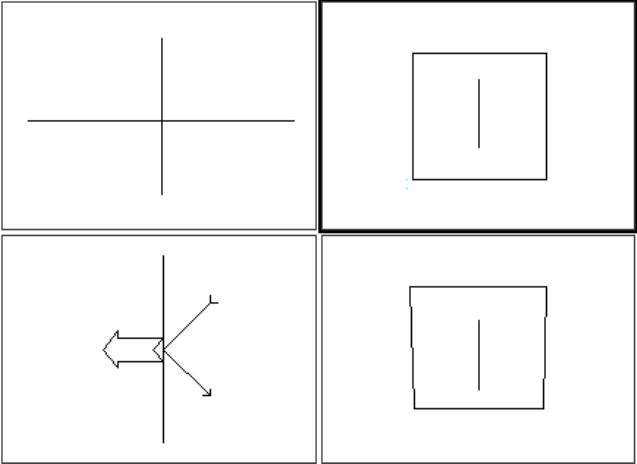
PDynaflect viewport icon
Procedures
Many dynaflector parameters are the same as those for omniflectors. However,
the procedure of associating the dynaflector with both the particle system
and the object to be affected is more complex than the simple binding used
by omniflector.
To create a particle/dynamics system:
1Create or load a scene containing a non-event-driven particle system on
page 2923 and an object to be affected by the particles (hereafter called
"the object"). Position and orient the two as desired so that the particles
strike the object.
■The icon for the particle system must be visible in at least one
non-disabled viewport.
■On the Basic Parameters rollout of the particle system, set Percentage
of Particles to 100%. Otherwise, only those particles displayed in the
viewport will be calculated.
Deflectors | 2657

2 On the Create panel, click Space Warps. Choose Deflectors
from the drop-down list, and then click one of the dynaflector buttons
(PDynaFlect, SDynaFlect, or UDynaFlect). Drag in a viewport to create
the deflector.
3Do either of the following:
■If using a PDynaFlect or SDynaFlect, position the space warp icon
where the particles strike (or will strike) the object. Resize and orient
it as needed.
Also, link the PDynaFlect or SDynaFlect as a child of the object.
This step isn't absolutely necessary, but allows the deflector to follow
the object as it moves.
■If using a UDynaFlect, go to the Modify panel > Parameters rollout,
click the Pick Object button, and then select the object. The position
of the space warp icon doesn't matter, and it's not necessary to link
the two.
4 Bind the particle system to the dynaflector using the toolbar Bind
to Space Warp button on page 2609 .
5 Go to the Utilities panel and open the Dynamics utility.
6On the Dynamics rollout, click New to create a new simulation.
7Click Edit Object List, and add the object to the dynamics simulation.
8Click Edit Object. On the Edit Object dialog, click Assign Object Effects
and assign the dynaflector to the object.
9On the Dynamics rollout, turn on the Update Display w/Solve check box
above the Solve button.
10 Solve the simulation.
2658 | Chapter 12 Space Warps and Particle Systems
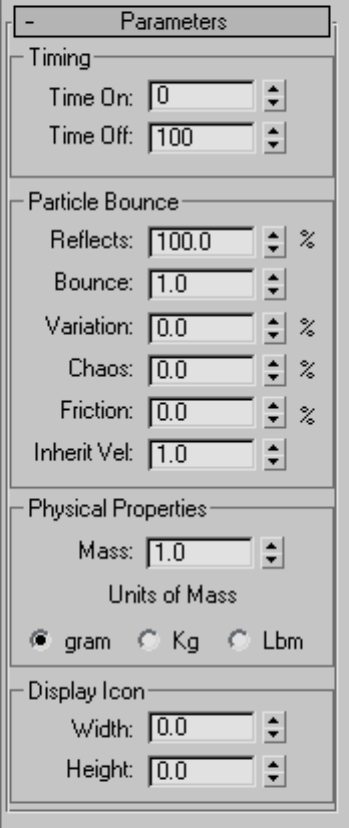
Interface
Timing group
The two spinners specify the start frame and end frame of the deflection effect.
Deflectors | 2659

Time On/Off Time On specifies the frame at which the deflection begins,
and Time Off specifies the frame at which the deflection ends.
Particle Bounce group
These settings affect the reflection of particles from the space warp.
Reflects Specifies the percentage of particles to be reflected by the PDynaFlect.
This affects both the particles and the dynamics reaction of the object struck
by the particles. The more particles that strike the affected object, the more
force applied to that object. If set to 0.0, the particles have no effect on the
object.
Bounce This is a multiplier that specifies how much of the initial speed of
the particle is maintained after collision with the PDynaFlect.
Using the default setting of 1.0 causes the particle to rebound with the same
speed as it collides. A real-world effect would usually be less than 1.0. For a
"flubber" effect, set greater than 1.0.
Variation Specifies the variation of Bounce applied to the range of particles.
For example, a Variation setting of 50% applied to a Bounce setting of 1.0
would result in randomly applied Bounce values ranging from 0.5 to 1.5.
Chaos Applies a random variation to the bounce angle.
When you set Chaos to 0.0 (no chaos), all particles bounce off the PDynaFlect
surface perfectly (like banking pool balls). A non-zero setting causes the
deflected particles to scatter.
Friction The amount by which particles are slowed as they move along the
deflector surface. A value of 0% means they're not slowed at all. A value of
50% means they're slowed to half their original speed. A value of 100% means
they stop moving when they strike the surface. Default=0%. Range=0% to
100%.
TIP To have particles slide along a deflector surface, set Bounce to 0. Also, unless
influenced by a force such as Wind or Gravity, particles meant to slide should strike
the surface at an angle other than 90 degrees.
Inherit Vel (Velocity Inheritance) Determines how much of a moving
PDynaFlect’s speed is applied to reflected or refracted particles.
For example, if Inherit Vel is 1.0, particles with no motion that are hit by a
moving PDynaFlect inherit the speed of the PDynaFlect at the point of
collision.
2660 | Chapter 12 Space Warps and Particle Systems
Physical Properties group
These options let you set the mass of each particle.
Mass Specifies the mass based on the chosen unit.
gram One gram equals 1/1000 kg or 22/1000 Lbm at a gravity of 1.0.
Kg One kg (kilogram) equals 1000 grams or 2.2 Lbm at a gravity of 1.0.
Lbm One Lbm (pounds-mass) equals 5/11 kg or 454 5/11 grams at a gravity
of 1.0. (Pounds-mass, the amount of mass in one pound of weight, is dependent
on gravity. For pounds-mass values at a gravity other than 1.0, multiply the
pounds-mass value by the gravity factor.)
Display Icon group
Width/Height Specify the width and height of the PDynaFlect icon. This is
for display purposes only and does not influence the deflector effect.
SOmniFlect Space Warp
Create panel > Space Warps > Deflectors > Object Type rollout > SOmniFlect
SOmniFlect is the spherical version of the omniflector type of space warp. It
provides more options than the original SDeflector. Most settings are the same
as those in POmniFlect on page 2650 . The difference is that this space warp
provides a spherical deflection surface rather than the planar surface. The only
settings that are different are in the Display Icon area, in which you set the
Radius, instead of the Width and Height.
Deflectors | 2661
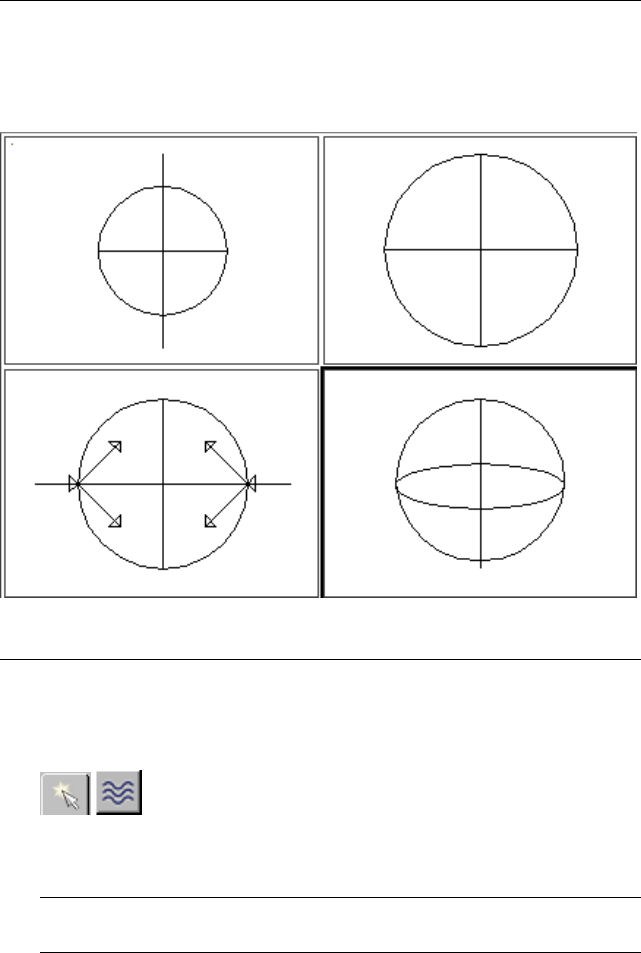
NOTE Opposite sides of the deflectors reverse the distortion effect. Thus, a refracted
particle passing through the SOmniFlect hits its outside surface first, and then its
inside surface. A positive Distortion value warps the particles toward the
perpendicular; then, as the particles pass through the inside surface, the same
positive Distortion value warps them toward the parallel.
SOmniFlect viewport icon
Procedures
To create an SOmniFlect space warp:
1 On the Create panel, click Space Warps. Choose Deflectors
from the list, then on the Object Type rollout, click SOmniFlect.
2Drag in a viewport to create the spherical icon.
NOTE Because particles bounce off the icon, the size of the icon affects
particle deflection.
2662 | Chapter 12 Space Warps and Particle Systems
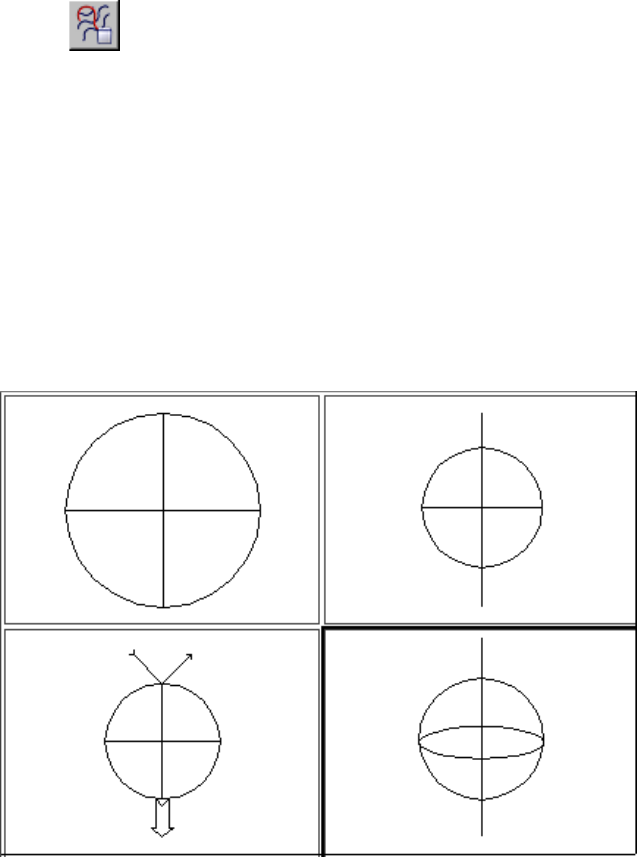
3Apply the deflector to the particle system using the appropriate method:
■If using Particle Flow on page 2713 , specify the deflector in the
Collision test on page 2881 or Collision Spawn test on page 2885
parameters.
■ If using a non-event-driven particle system on page 2923 , bind
on page 2609 the particle system to the deflector icon.
4Position the SOmniFlect icon to interrupt the particle stream.
5Adjust the SOmniFlect parameters as necessary.
SDynaFlect Space Warp
Create panel > Space Warps > Deflectors > Object Type rollout > SDynaFlect
The SDynaFlect space warp is a spherical dynamics deflector. It’s like the
PDynaFlect on page 2656 warp, except that it’s spherical, and its Display Icon
spinner specifies the icon's Radius value.
SDynaFlect viewport icon
Deflectors | 2663
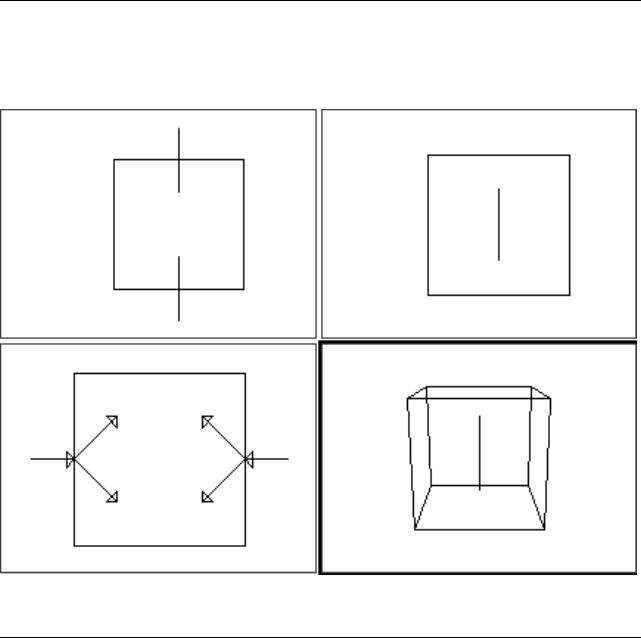
UOmniFlect Space Warp
Create panel > Space Warps > Deflectors > Object Type rollout > UOmniFlect
UOmniFlect, the universal omniflector, provides more options than the original
UDeflector. This space warp lets you use any other geometric object as a particle
deflector. The deflections are face accurate, so the geometry can be static,
animated, or even morphing or otherwise deforming over time.
NOTE Some particle “leakage” can occur with this deflector, particularly when
you use many particles and a complex deflector object. To avoid this, perform a
test render to check for leaking particles, and then add POmniFlects to catch the
strays.
UOmniFlect viewport icon
2664 | Chapter 12 Space Warps and Particle Systems
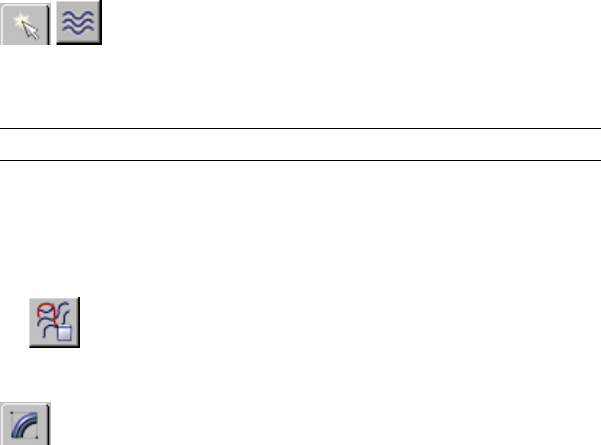
Procedures
To use the UOmniFlect space warp:
To use a universal omniflector, you need a minimum of three objects in the
scene:
1The particle system
2The UOmniFlect space warp
3The object used as the deflector
4Add or select an object used as the deflector.
5Create a particle system whose particles intersect the deflector object.
6 On the Create panel, click Space Warps. Choose Deflectors
from the list, and then click UOmniFlect.
7Click and drag in a viewport to place the space warp icon.
NOTE The size and position of the UOmniFlect icon do not alter the effect.
8Apply the deflector to the particle system using the appropriate method:
■If using Particle Flow on page 2713 , specify the deflector in the
Collision test on page 2881 or Collision Spawn test on page 2885
parameters.
■ If using a non-event-driven particle system on page 2923 , bind
on page 2609 the particle system to the deflector icon.
9 On the Modify panel > Parameters rollout > Object-Based
OmniFlector group, click Pick Object, and then select the object to use
as a deflector.
10 Adjust the particle system and UOmniFlect parameters as necessary.
Deflectors | 2665
Interface
Parameters rollout
The settings for the UOmniFlect are the same as those for POmniFlect on
page 2650 , with the following additions:
Object-Based OmniFlector group
Lets you choose the object to use as a deflector.
Item Displays the name of the selected object.
Pick Object Click this, and then select any renderable object to use as a
deflector.
Display Icon group
Icon Size Specifies the size of one side of the square UOmniFlect icon.
UDynaFlect Space Warp
Create panel > Space Warps > Deflectors > Object Type rollout > UDynaFlect
The UDynaFlect space warp is a universal dynamics deflector that lets you use
the surface of any object as both the particles deflector and the surface that
reacts dynamically to the particle impact.
The procedures and options for using UDynaFlect are the same as for
PDynaFlect on page 2656 , with the following changes and additions.
2666 | Chapter 12 Space Warps and Particle Systems
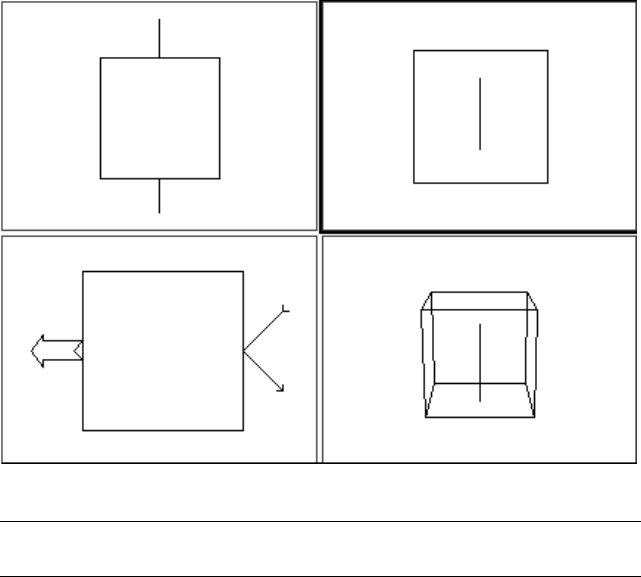
UDynaFlect viewport icon
NOTE When you use UDynaFlect, you must indicate the object to be affected
with the Pick Object button. Linking is not necessary.
Deflectors | 2667
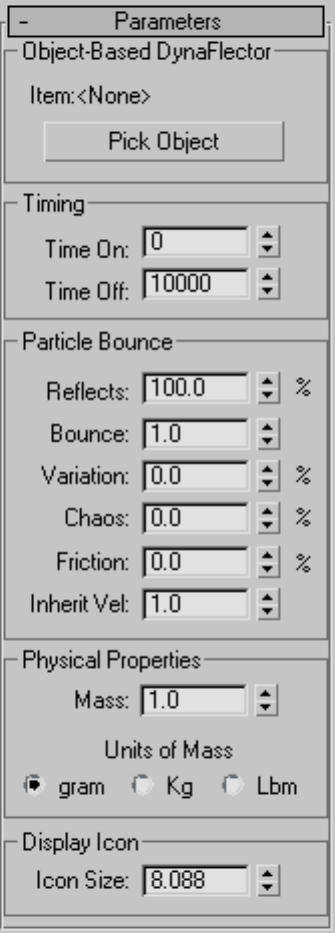
Interface
2668 | Chapter 12 Space Warps and Particle Systems
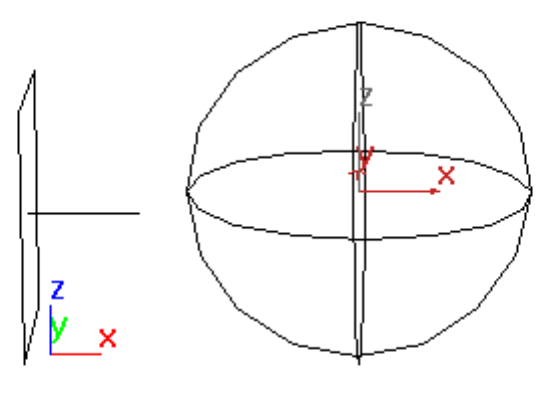
Object-Based DynaFlector group
Lets you choose the object to use as a deflector.
Item Displays the name of the selected object.
Pick Object Click this, and then select any renderable object to use as a
deflector.
Display Icon group
Icon Size Specifies the size of the UDynaFlect icon.
SDeflector Space Warp
Create panel > Space Warps > Deflectors > Object Type rollout > SDeflector
Create menu > Space Warps > Deflectors > SDeflector
The SDeflector space warp serves as a spherical deflector of particles.
SDeflector viewport icon (with particle system on the left)
Deflectors | 2669
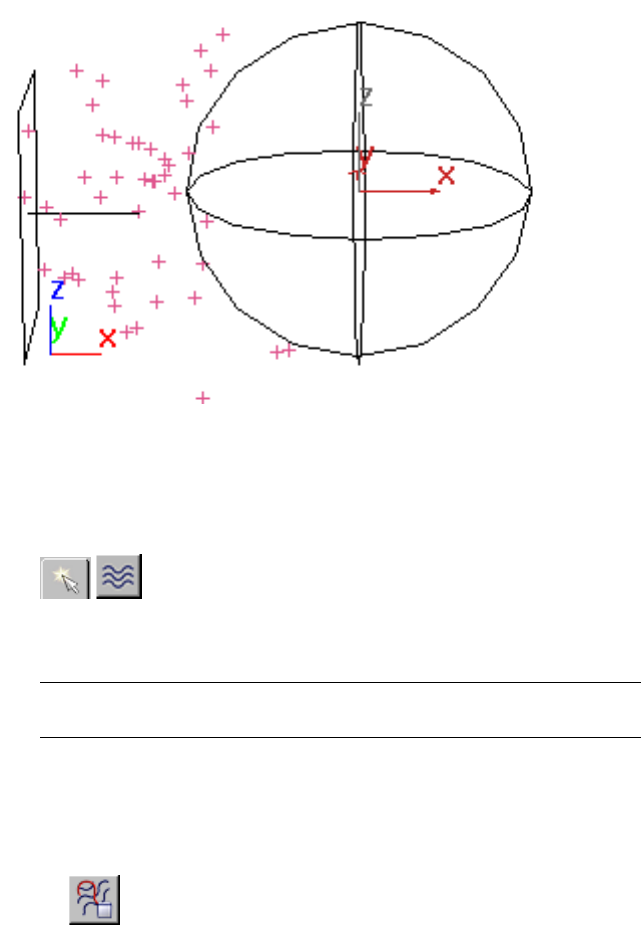
SDeflector repelling particles
Procedures
To create an SDeflector:
1 On the Create panel, click Space Warps. Choose Deflectors
from the list, then on the Object Type rollout, click SDeflector.
2Drag in a viewport to create the spherical icon.
NOTE Because particles bounce off the perimeter of the spherical icon, the
size of the icon affects particle deflection.
3Apply the deflector to the particle system using the appropriate method:
■If using Particle Flow on page 2713 , specify the deflector in the
Collision test on page 2881 or Collision Spawn test on page 2885
parameters.
■ If using a non-event-driven particle system on page 2923 , bind
on page 2609 the particle system to the deflector icon.
4Position the SDeflector icon to interrupt the particle stream.
2670 | Chapter 12 Space Warps and Particle Systems
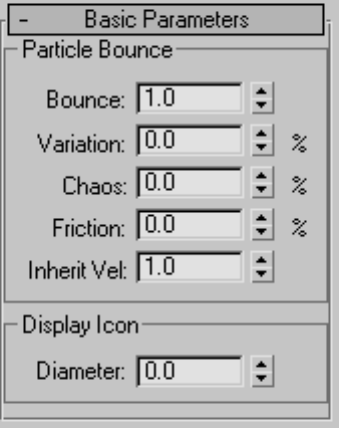
5Adjust the SDeflector parameters as necessary.
Interface
Particle Bounce group
These settings determine how the deflector affects the bound particles.
Bounce Determines the speed with which particles bounce off the deflector.
At 1.0, the particles bounce at the same speed as they approach. At 0, they
don't deflect at all.
Variation The amount by which each particle can vary from the Bounce
setting.
Chaos The amount of variation from the perfect angle of reflection (found
when Chaos is set to 0.0). 100% induces a variation in reflection angle of up
to 90 degrees
Friction The amount by which particles are slowed as they move along the
deflector surface. A value of 0% means they're not slowed at all. A value of
50% means they're slowed to half their original speed. A value of 100% means
they stop moving when they strike the surface. Default=0%. Range=0% to
100%.
Deflectors | 2671

TIP To have particles slide along a deflector surface, set Bounce to 0. Also, unless
influenced by a force such as Wind or Gravity, particles meant to slide should strike
the surface at an angle other than 90 degrees.
Inherit Vel (Velocity Inheritance) When the value is greater than 0, the
motion of the deflector affects particles as well as the other settings. For
example, to animate the SDeflector passing through a passive array of particles,
turn up this value to affect the particles.
Display Icon group
This option affects the display of the icon.
Diameter Specifies the diameter of the SDeflector icon. This setting also
alters the effect of the deflection, because particles bounce off the perimeter
of the icon. The scale of the icon also affects the particles.
UDeflector Space Warp
Create panel > Space Warps > Deflectors > Object Type rollout > UDeflector
Create menu > Space Warps > Deflectors > UDeflector
2672 | Chapter 12 Space Warps and Particle Systems
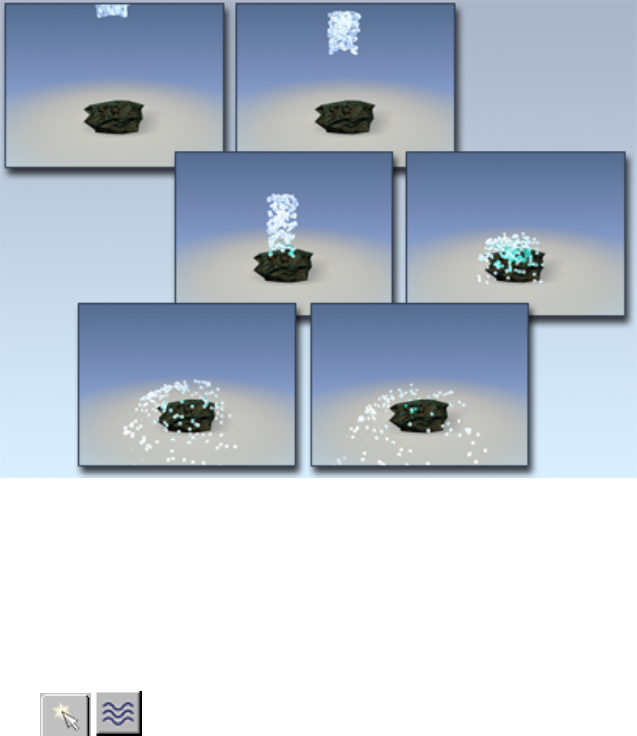
Particles scatter when they strike a UDeflector object
The UDeflector is a universal deflector that lets you use any object as a particle
deflector.
Procedures
To create a UDeflector:
1 On the Create panel, click Space Warps. Choose Deflectors
from the list, then on the Object Type rollout, click UDeflector.
2In a viewport, drag out a rectangle to add a UDeflector warp to the scene.
3On the command panel, click the Pick Object button and select an object
to be a particle deflector.
Deflectors | 2673
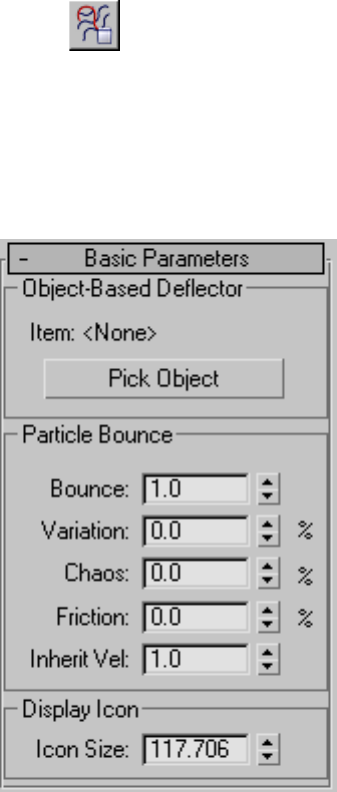
4Apply the deflector to the particle system using the appropriate method:
■If using Particle Flow on page 2713 , specify the deflector in the
Collision test on page 2881 or Collision Spawn test on page 2885
parameters.
■ If using a non-event-driven particle system on page 2923 , bind
on page 2609 the particle system to the deflector icon.
5Position the UDeflector icon to interrupt the particle stream.
6Adjust the UDeflector parameters as necessary.
Interface
Object-Based Deflector group
Specifies the object to use as a deflector.
2674 | Chapter 12 Space Warps and Particle Systems

Item Displays the name of the selected object.
Pick Object Click this, and then click any renderable mesh object to be used
as a deflector.
Particle Bounce group
Bounce Determines the speed with which particles bounce off the deflector.
At 1.0, the particles bounce at the same speed as they approach. At 0, they
don't deflect at all.
Variation The amount by which each particle can vary from the Bounce
setting.
Chaos The amount of variation from the perfect angle of reflection (found
when Chaos is set to 0.0). 100% induces a variation in reflection angle of up
to 90 degrees.
Friction The amount by which particles are slowed as they move along the
deflector surface. A value of 0% means they're not slowed at all. A value of
50% means they're slowed to half their original speed. A value of 100% means
they stop moving when they strike the surface. Default=0%. Range=0% to
100%.
TIP To have particles slide along a deflector surface, set Bounce to 0. Also, unless
influenced by a force such as Wind or Gravity, particles meant to slide should strike
the surface at an angle other than 90 degrees.
Inherit Vel (Velocity Inheritance) When greater than 0, the motion of the
deflector affects particles as well as the other settings. For example, to animate
the SDeflector passing through a passive array of particles, turn up this value
to affect the particles.
Display Icon group
Icon Size This spinner displays and lets you change the size of the icon.
Deflector Space Warp
Create panel > Space Warps > Deflectors > Object Type rollout > Deflector
Create menu > Space Warps > Deflectors > Deflector
Deflectors | 2675
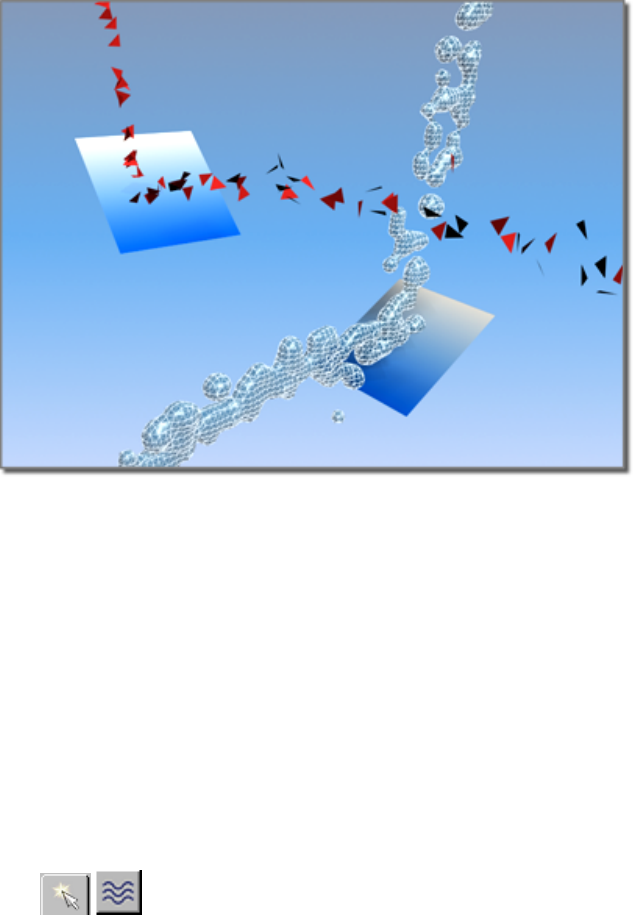
Two streams of particles striking two deflectors
The Deflector space warp acts as a planar shield to repel the particles generated
by a particle system. For example, you can use Deflector to simulate pavement
being struck by rain. You can combine a Deflector space warp with a Gravity
space warp to produce waterfall and fountain effects.
See also:
■SDeflector Space Warp on page 2669
■UDeflector Space Warp on page 2672
Procedures
To create a deflector:
1 On the Create panel, click Space Warps. Choose Deflectors
from the list, then on the Object Type rollout, click Deflector.
2Drag in a viewport to define the deflection area.
2676 | Chapter 12 Space Warps and Particle Systems
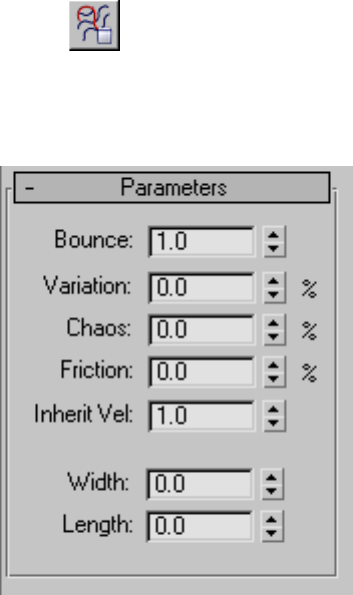
The deflector appears as a wireframe rectangle.
3Apply the deflector to the particle system using the appropriate method:
■If using Particle Flow on page 2713 , specify the deflector in the
Collision test on page 2881 or Collision Spawn test on page 2885
parameters.
■ If using a non-event-driven particle system on page 2923 , bind
on page 2609 the particle system to the deflector icon.
Interface
The deflector's effect is controlled mainly by its size and orientation in the
scene, relative to the particle system that is bound to it. You can also adjust
how strongly the deflector deflects particles.
Bounce Controls the speed at which particles bounce off the deflector. At a
setting of 1.0, particles bounce off the deflector at the same speed they struck
it. At 0.0, particles do not bounce at all. At values between 0.0 and 1.0, particles
bounce off the deflector at a speed reduced from their initial speed. At values
greater than 1.0, particles bounce off the deflector at a speed greater than their
initial speed. Default=1.0.
Deflectors | 2677

Variation The amount by which each particle can vary from the Bounce
setting.
Chaos The amount of variation from the perfect angle of reflection (found
when Chaos is set to 0.0). 100% induces a variation in reflection angle of up
to 90 degrees
Friction The amount by which particles are slowed as they move along the
deflector surface. A value of 0% means they're not slowed at all. A value of
50% means they're slowed to half their original speed. A value of 100% means
they stop moving when they strike the surface. Default=0%. Range=0% to
100%.
TIP To have particles slide along a deflector surface, set Bounce to 0. Also, unless
influenced by a force such as Wind or Gravity, particles meant to slide should strike
the surface at an angle other than 90 degrees.
Inherit Vel (Velocity Inheritance) When the value is greater than 0, the
motion of the deflector affects particles as well as the other settings. For
example, if you want an animated SDeflector passing through an array of
particles to affect the particles, turn up this value.
Width Sets the deflector's width.
Length Sets the deflector's length.
Geometric/Deformable
FFD(Box) Space Warp
Create panel > Space Warps > Geometric/Deformable > Object Type rollout >
FFD(Box)
Create menu > Space Warps > Geometric/Deformable > FFD(Box)
Free-form deformations (FFDs) provide a method of deforming an object by
adjusting the control points of a lattice. The offset position of the control
points to the original lattice source volume causes the distortion of the affected
object.
The FFD(Box) space warp is a box-shaped lattice FFD object similar to the
original FFD modifiers. This FFD is available as both an object modifier and
a space warp. For information on the object-modifier version, see FFD
(Box/Cylinder) Modifiers on page 1389 .
2678 | Chapter 12 Space Warps and Particle Systems
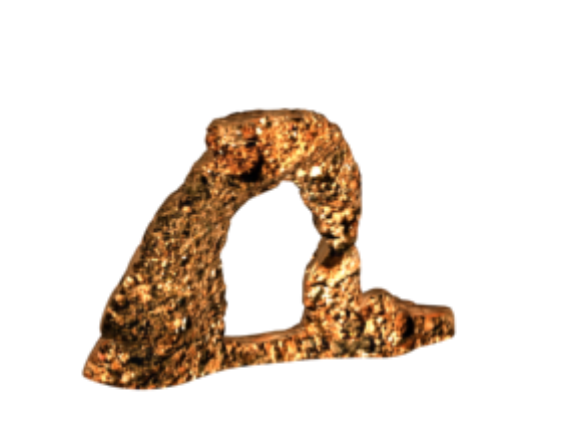
You create FFD space warps as separate objects similarly to the way you create
standard primitives: by dragging the mouse in the viewport. The result is a
lattice of control points. The source lattice of an FFD modifier is fitted to the
geometry it's assigned to in the stack. This might be a whole object or a
sub-object selection of faces or vertices.
Because FFD space warps are separate objects, they carry their own adjustable
dimension parameters among the creation parameters.
You can apply object modifiers to space warp objects. For example, you can
use the Linked XForm modifier with a space-warp FFD.
Geometric/Deformable | 2679
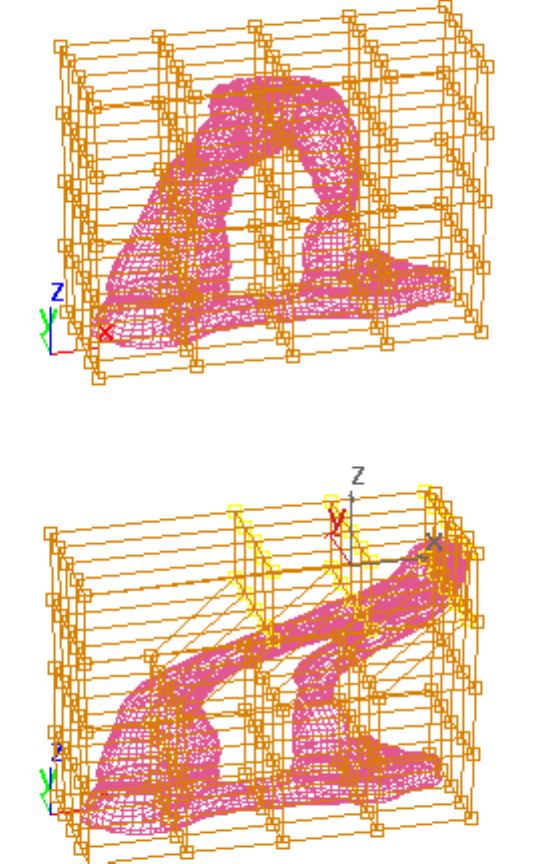
Object and object surrounded by an FFD lattice
2680 | Chapter 12 Space Warps and Particle Systems
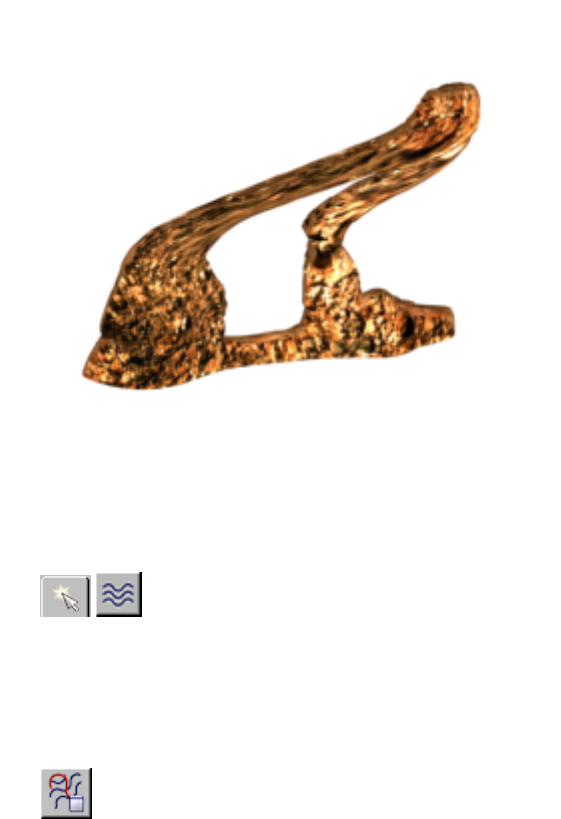
Moving control points in the lattice deforms the object.
Procedures
To use the FFD(box) space warp:
1 On the Create panel, click Space Warps. Choose
Geometric/Deformable from the list, then on the Object Type rollout,
click FFD(Box).
2Drag in a viewport to create the base. Release the mouse button, and then
move the mouse to define the height of the FFD lattice. Click to finish
the lattice.
3 Bind the lattice to the object you want to deform.
4Determine the relative placement of the lattice to the object.
If the lattice is to be outside of the object, turn on All Vertices. To affect
only those vertices inside the lattice, choose Only In Volume, and position
the lattice accordingly.
Geometric/Deformable | 2681
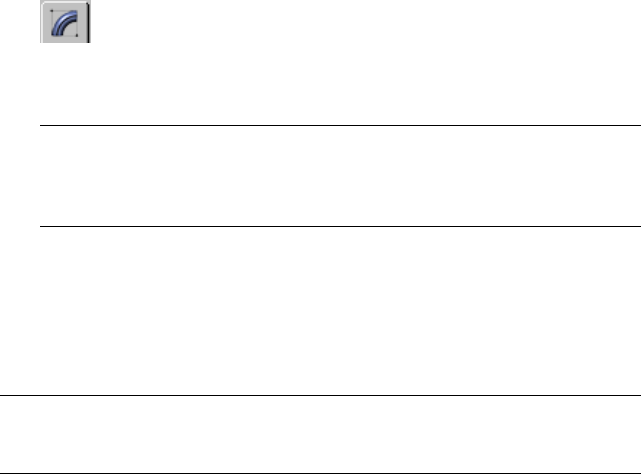
5 In the modifier stack display, choose Control Points as the
sub-object level for FFD(box).
6Adjust the control points.
NOTE The distortion effect of an FFD modifier is based on the positional
offset of the control points from their original positions in the source volume.
If you don't move control points, there is no effect on the target object. Keep
this in mind when using space-warp version of the FFD.
If you're using the Deform group > All Vertices option, once you've distorted
the object you can set the Falloff value to adjust how much the lattice affects
the object, based on distance. This is particularly useful if the lattice is animated
to approach or move away from the target object. When Falloff is set to 0, all
the vertices are affected, regardless of distance.
NOTE When you're at the base-parameters level of an FFD modifier in the Stack,
the Show End Result button is turned off and spring-loaded, as it is in an Edit Mesh
modifier.
2682 | Chapter 12 Space Warps and Particle Systems
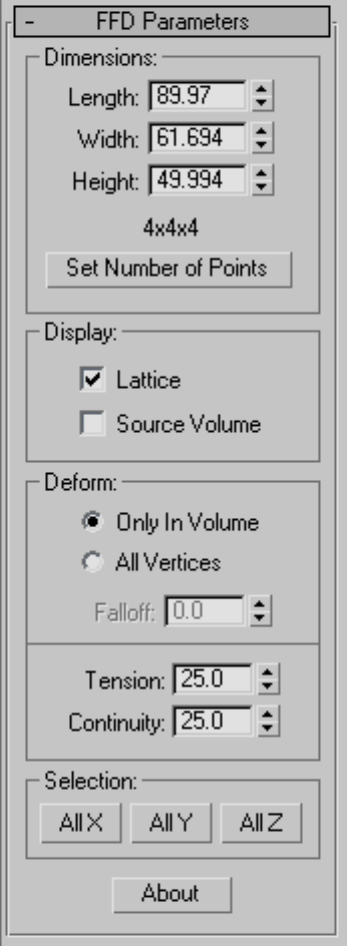
Interface
Geometric/Deformable | 2683

This rollout lets you set the size and resolution of the lattice, and how it
displays and deforms.
Dimensions group
These options let you adjust the unit dimensions of the source volume, and
specify the number of control points in the lattice. Note that the point
dimensions are displayed beside the modifier name in the Stack list.
Length, Width, Height These three spinners display and let you adjust the
length, width, and height of the lattice. To create the space warp, you drag
the mouse in the same way that you would to create a standard Box primitive.
Note that these spinners don't exist in the object-modifier version of the FFD.
Label Displays the current number of controls points in the lattice (for
example: 4x4x4).
Set Number of Points Displays a dialog containing three spinners labeled
Length, Width, and Height, plus OK/Cancel buttons. Specify the number of
control points you want in the lattice, and then click OK to make the change.
NOTE Make changes to the dimensions before you adjust the positions of the
lattice control points. When you change the number of control points with this
dialog, any adjustments you've already made to the control points are lost;
however, you can undo this use of the dialog.
Display group
These options affect the display of the FFD in the viewports.
Lattice When turned on, lines are drawn connecting the control points to
make a grid. Although viewports can become cluttered when these extra lines
are drawn, they help to visualize the lattice.
Source Volume When on, the control points and lattice are displayed in
their unmodified state. This display is helpful when you're adjusting the source
volume to affect specific vertices that lie within or without it. See the All
Vertices and Only in Volume options, later in this topic.
Deform group
These options provide controls that specify which vertices are affected by the
FFD.
Only In Volume Only vertices that lie inside the source volume are deformed.
Vertices outside the source volume are not affected.
2684 | Chapter 12 Space Warps and Particle Systems
All Vertices All vertices are deformed regardless of whether they lie inside
or outside the source volume, depending on the value in the Falloff spinner.
The deformation outside the volume is a continuous extrapolation of the
deformation inside the volume. The deformation can be extreme for points
far away from the source lattice.
Falloff This spinner, enabled only when you choose All Vertices, determines
the distance from the lattice that the FFD effect will decrease to zero. When
this spinner is set to 0, it's effectively turned off, and there is no falloff; that
is, all vertices are affected regardless of their distance from the lattice. The
units of the Falloff parameter are specified relative to the size of the lattice: A
falloff of 1 means that the effect will go to 0 for points that are a lattice
width/length/height away from the lattice (depending on which side they are
on).
Tension/Continuity Lets you adjust the tension and continuity of the
deformation splines. Although you can't see the splines in an FFD, the lattice
and control points represent the structure that controls the splines. As you
adjust the control points, you alter the splines (which move through each
point). The splines, in turn, deform the geometry of the object. By altering
the tension and continuity of the splines, you alter their effect on the object.
Selection group
These options provide additional methods of selecting the control points. You
can toggle the state of any combination of the three buttons to select in one,
two, or three dimensions at once.
All X, All Y, All Z When one of these buttons is on and you select a control
point, all control points along the local dimension specified by the button
are selected as well. By turning on two buttons, you can select all control
points in two dimensions.
About Displays a dialog with copyright and licensing information.
FFD(Cyl) Space Warp
Create panel > Space Warps > Geometric/Deformable > Object Type rollout >
FFD(Cyl)
Create menu > Space Warps > Geometric/Deformable > FFD(Cyl)
Free-form deformations (FFDs) provide a method of deforming an object by
adjusting the control points of a lattice. The offset position of the control
Geometric/Deformable | 2685
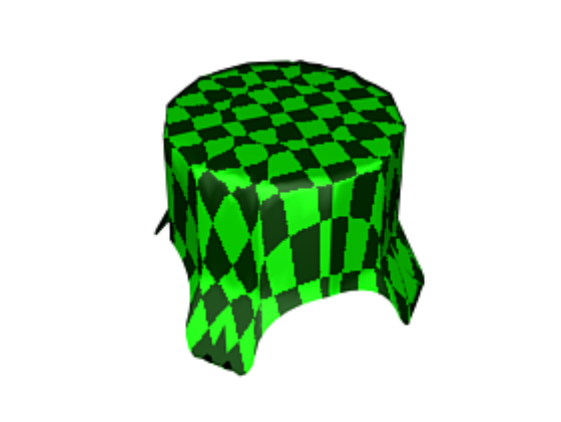
points to the original lattice source volume causes the distortion of the affected
object.
The FFD(Cyl) space warp uses a cylindrical array of control points in its lattice.
This FFD is available as both an object modifier and a space warp. For
information on the object modifier version, see FFD (Box/Cylinder) Modifiers
on page 1389 .
You create FFD space warps as separate objects similarly to the way you create
standard primitives: by dragging the mouse in the viewport. The result is a
lattice of control points. The source lattice of an FFD modifier is fitted to the
geometry it's assigned to in the stack. This might be a whole object or a
sub-object selection of faces or vertices.
Because FFD space warps are separate objects, they carry their own adjustable
dimension parameters among the creation parameters.
You can apply object modifiers to space warp objects. For example, you can
use the Linked XForm modifier with a space-warp FFD.
Procedures
Example: Create an animated tablecloth:
Finished tablecloth using FFD (Cyl) space warp
2686 | Chapter 12 Space Warps and Particle Systems
This example shows how to use the FFD(Cyl) space warp to create a tablecloth
that flies in and drapes itself over a table.
Begin by creating the table and tablecloth.
1Create a table from two cylinders. Make the table top with a radius of 30
units, and a height of 2 units. Make the "table stand" cylinder with a
radius of 3 and a height of 60.
2Make a tablecloth from a box 100 units square and 0.5 units in height.
Increase Length and Width Segments to 30, and keep Height Segments
at 1.
3Position the tablecloth so it's level with or slightly above the table top,
and a little less than 100 units to the left of the table edge, as seen from
the Top view.
4Apply a nice wood grain to the table, and a checker to the tablecloth.
(Set the checker tiling to about 15x15, and choose any color for the
checkers.)
Now, set up a cylindrical FFD space warp that will form the drape of the
tablecloth over the table.
1From the Create panel > Space Warps > Geometric/Deformable, choose
FFD(Cyl).
2In the Top viewport, create a cylindrical FFD space warp, centered on the
table top, with a radius of 45 and a height of 5.
3Click the Set Number of Points button and, in the Set FFD Dimensions
dialog, set Side points to 12, Radial points to 5, and Height points to 2.
4Move the entire FFD lattice up until it's just over the surface of the table,
as seen from the Front viewport.
Geometric/Deformable | 2687
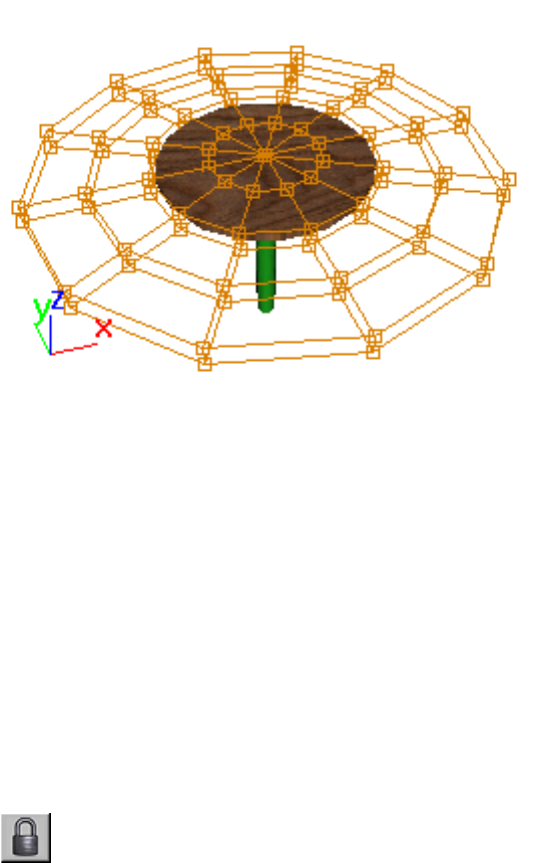
Next, adjust the control points of the lattice to drape over the table.
1Zoom Extents All Selected.
2On the Modify panel, in the stack display (below "Modifier List"), click
the FFD(cyl) item so it turns yellow. This means you've enabled direct
access to the FFD space warps control point sub-objects.
3In the FFD Parameters rollout > Selection group, turn on All X. This lets
you select control points around the perimeter of the FFD cylinder.
4In the Top viewport, use the Select and Move tool on page 888 and
region-select the two visible control points of the two outer rings of
control points at the nine-o'clock position. (This is easier shown than
described. You can actually region-select any number of vertices in the
two outer concentric rings of vertices. Because All X is on, all control
points for the two rings will be selected.)
5 On the status bar, click the Selection Lock Toggle button to lock
the selection. In the Front viewport, drag the selected points halfway
down the height of the table.
6Unlock the selection, and then region-select any control point in the
outer ring to select all points in the outer ring.
2688 | Chapter 12 Space Warps and Particle Systems
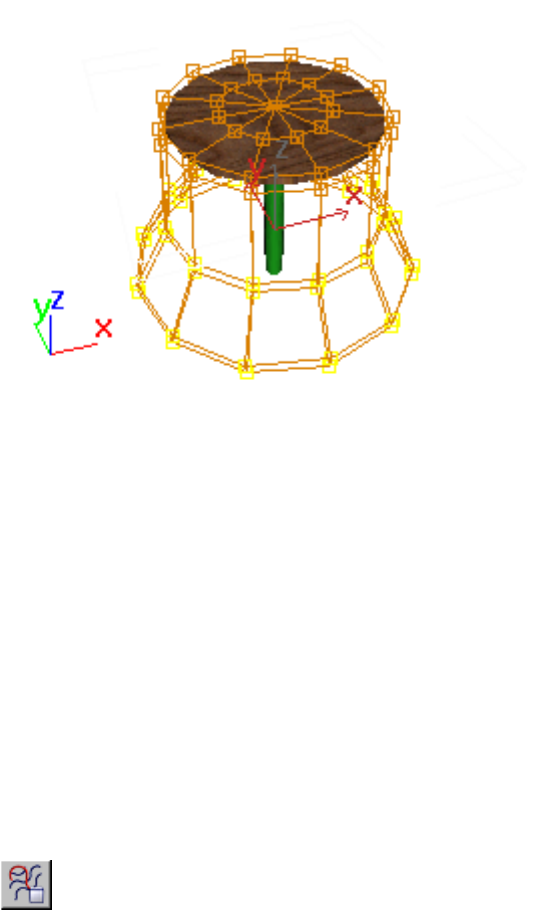
7Lock the selection and, in the Front viewport, drag the outer ring of points
down to the floor.
You now have a truncated cone shape over the table.
8Unlock the selection. In the Top viewport, again select all the control
points in the two outer rings.
9Scale the selected control points in, until the radius of the inner ring of
points is slightly larger than the table top.
10 Select only the outer ring of points, and scale them so their radius is
slightly larger than the inner ring.
If necessary, move the points, as seen from the Front viewport, down to
touch the floor again.
You now have a lattice of control points draped over the table.
In this next series of steps, you'll bind the tablecloth to the FFD lattice, and
then animate it to move over the table.
1In the stack display, click the FFD(cyl) entry again to exit the sub-object
level. It turns gray.
2 In the main toolbar, click the Bind to Space Warp button, and
drag between the FFD and the tablecloth.
Geometric/Deformable | 2689
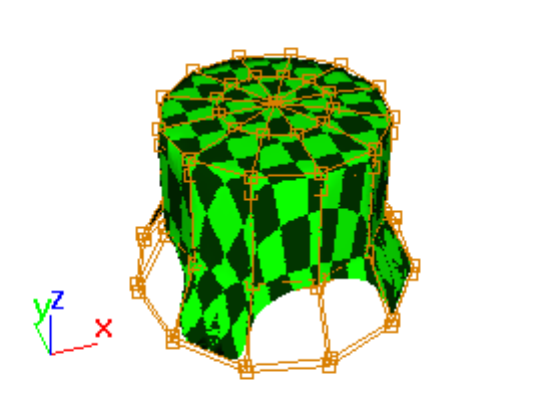
3Select the FFD lattice.
4Choose Deform group > All Vertices.
The tablecloth is immediately deformed because all vertices are now
affected, including those outside the lattice volume, and Falloff is set to
0. A falloff value of 0 means that the distance of the vertices from the
lattice doesn't matter. Any number greater than 0, however, limits the
effect.
5Set the Falloff spinner to 0.4.
No longer influenced by the FFD space warp, the tablecloth returns to
its square shape.
6Turn on Auto Key, and go to frame 100.
7In the Top viewport, select the tablecloth, and move it until it's centered
over the table.
8As the tablecloth nears the table, it droops down to the floor, sweeps up
and over the table, and finally drapes itself over the table.
9As you move the time slider back and forth and examine the animation,
you might find that the bottom of the tablecloth is deformed to the point
where it's hanging below the floor. To fix this, turn off Auto Key, go to
frame 100, select the lower ring of control points, and move them up
2690 | Chapter 12 Space Warps and Particle Systems
until the tablecloth is at the height you want it. You can also adjust the
position of the other control points to create drapes, and so on.
10 On the Display command panel > Hide by Category rollout, turn on
Space Warps to hide the FFD space warp.
11 Set up appropriate lights and a camera, and play your animation.
Geometric/Deformable | 2691
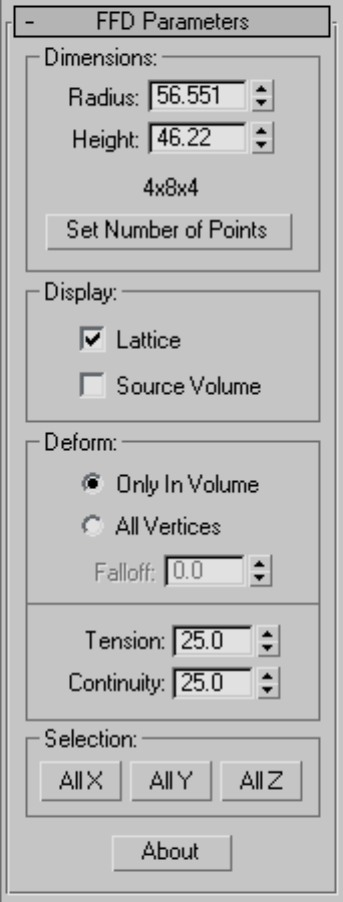
Interface
2692 | Chapter 12 Space Warps and Particle Systems

This rollout lets you set the size and resolution of the lattice, and how it
displays and deforms.
Dimensions group
These options let you adjust the unit dimensions of the source volume, and
specify the number of control points in the lattice. Note that the point
dimensions are displayed beside the modifier name in the Stack list.
Radius, Height These two spinners display and let you adjust the length,
width, and height of the lattice. To create the space warp, drag the mouse in
the same way that you would to create a standard Cylinder primitive. Note
that these spinners don't exist in the object-modifier version of the FFD.
Label Displays the current number of controls points in the lattice (for
example: 4x8x4).
Set Number of Points Displays a dialog containing three spinners labeled
Side, Radial, and Height, plus OK/Cancel buttons. Specify the number of
control points you want in the lattice, and then click OK to make the change.
Side The number of control points around the perimeter of the lattice.
Radial The number of control points, radially, from the center to the outer
perimeter of the lattice.
Height The number of control points along the height of the lattice.
NOTE Make changes to the dimensions before you adjust the positions of the
lattice control points. When you change the number of control points with this
dialog, any adjustments you've already made to the control points are lost;
however, you can undo this use of the dialog.
Display group
These options affect the display of the FFD in viewports.
Lattice When on, lines are drawn connecting the control points to make a
grid. Although viewports can become cluttered when these extra lines are
drawn, they help to visualize the lattice.
Source Volume When on, the control points and lattice are displayed in
their unmodified state. This display is helpful when you're adjusting the source
volume to affect specific vertices that lie within or without it. See the All
Vertices and Only in Volume options, later in this topic.
Geometric/Deformable | 2693
Deform group
These options provide controls that specify which vertices are affected by the
FFD.
Only In Volume When on, only vertices that lie inside the source volume
are deformed. Vertices outside the source volume are not affected. This is the
default choice.
All Vertices When on, all vertices are deformed regardless of whether they
lie inside or outside the source volume, depending on the value in the Falloff
spinner. The deformation outside the volume is a continuous extrapolation
of the deformation inside the volume. Note that the deformation can be
extreme for points far away from the source lattice.
Falloff This spinner, enabled only when you choose All Vertices, determines
the distance from the lattice that the FFD effect will decrease to zero. When
this spinner is set to 0, it's effectively turned off, and there is no falloff; that
is, all vertices are affected regardless of their distance from the lattice. The
units of the Falloff parameter are specified relative to the size of the lattice: A
falloff of 1 means that the effect will go to 0 for points that are a lattice
width/length/height away from the lattice (depending on which side they are
on).
Tension/Continuity Lets you adjust the tension and continuity of the
deformation splines. Although you can't see the splines in an FFD, the lattice
and control points represent the structure that controls the splines. As you
adjust the control points, you alter the splines (which move through each
point). The splines, in turn, deform the geometry of the object. By altering
the tension and continuity of the splines, you alter their effect on the object.
Selection group
These options provide additional methods of selecting control points. You
can toggle any combination of the three buttons to select in one, two, or three
dimensions at once.
All X, All Y, All Z When one of these buttons is on and you select a control
point, all control points along the local dimension specified by the button
are selected as well. By turning on two buttons, you can select all control
points in two dimensions.
About Displays a dialog with copyright and licensing information.
2694 | Chapter 12 Space Warps and Particle Systems
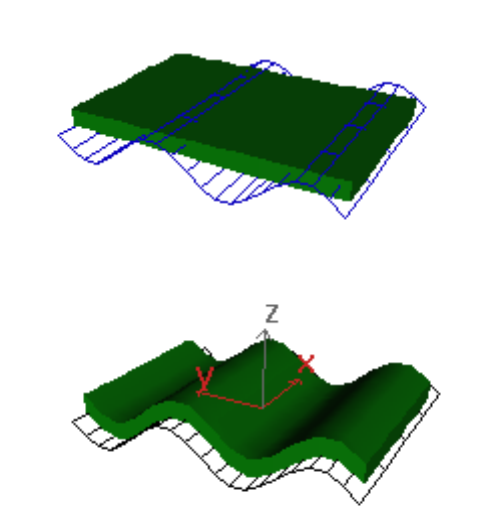
Wave Space Warp
Create panel > Space Warps > Geometric/Deformable > Object Type rollout >
Wave
Create menu > Space Warps > Geometric/Deformable > Wave
The Wave space warp creates a linear wave through world space. It affects
geometry and behaves the same as the Wave modifier on page 1918 . Use the
Wave space warp when you want the wave to affect a large number of objects,
or to affect an object relative to its position in world space.
Geometric/Deformable | 2695
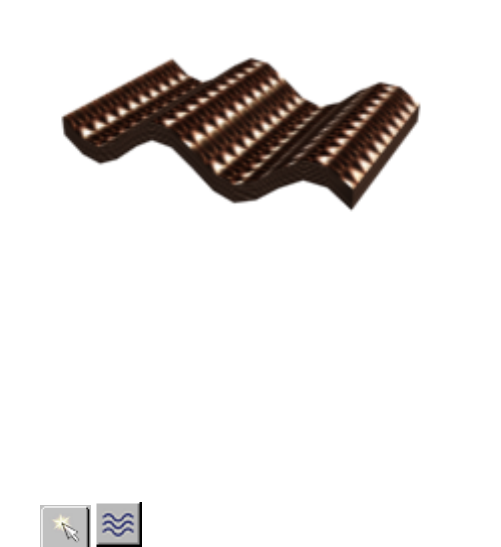
Using a wave to deform a box
See also:
■Ripple Space Warp on page 2699
Procedures
To create a Wave space warp:
1 On the Create panel, click Space Warps. Choose
Geometric/Deformable from the list, then on the Object Type rollout,
click Wave.
2Drag in a viewport to define the initial size of the wave object icon.
The icon is displayed as a flat mesh wireframe.
3Release the mouse button to set the icon size; then move the mouse to
define the initial amplitude of the wave.
4Click to set the wave amplitude.
2696 | Chapter 12 Space Warps and Particle Systems
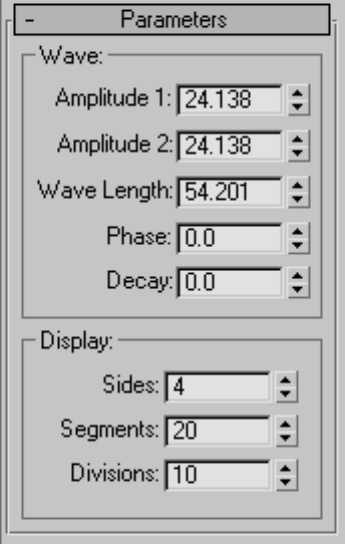
Interface
The initial amplitude sets both Amplitude 1 and Amplitude 2. Set these
parameters to unequal values to create a cross wave.
Wave group
These options control the wave effect.
Amplitude 1 Sets wave amplitude along the wave warp object's local X axis.
Amplitude 2 Sets wave amplitude along the wave warp object's local Y axis.
Amplitude is expressed in units. The wave is a sine wave along its Y axis and
parabolic along its X axis. Another way to think of the difference between the
amplitudes is that Amplitude 1 is at the center of the wave gizmo and
Amplitude 2 is at the edge of the gizmo.
Wave Length Sets the length of each wave along the wave's local Y axis, in
active units.
Geometric/Deformable | 2697
Phase Offsets the phase of the wave from its origin at the wave object's
center. Whole values have no effect; only fractional values do. Animating this
parameter makes the wave appear to travel through space.
Decay When set to 0.0, the wave has the same amplitude or amplitudes
throughout world space. Increasing the Decay value causes amplitude to
diminish as distance increases from the position of the wave warp object.
Default=0.0.
Display group
These options control the geometry of the Wave warp gizmo. In some cases,
such as when the two Amplitude values differ, they change the effect of the
wave.
Sides Sets the number of side segments along the wave object's local X
dimension.
Segments Sets the number of segments along the wave object's local Y
dimension.
Divisions Adjusts the size of the wave icon without altering the wave effect
as scaling would.
Flexibility parameter (Modify panel)
The Wave space warp also has a Flexibility parameter that you can adjust
individually in each bound object's stack, at the Wave Binding level. The
parameter belongs to each binding; it doesn't appear with the Wave warp
parameters.
2698 | Chapter 12 Space Warps and Particle Systems
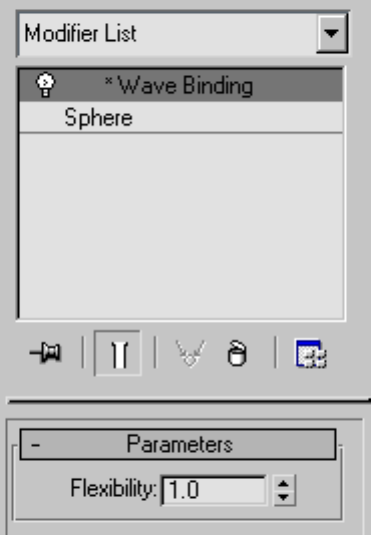
Flexibility Makes the bound object more or less responsive to the wave by
multiplying the amplitude by this value.
Ripple Space Warp
Create panel > Space Warps > Geometric/Deformable > Object Type rollout >
Ripple
Create menu > Space Warps > Geometric/Deformable > Ripple
Geometric/Deformable | 2699
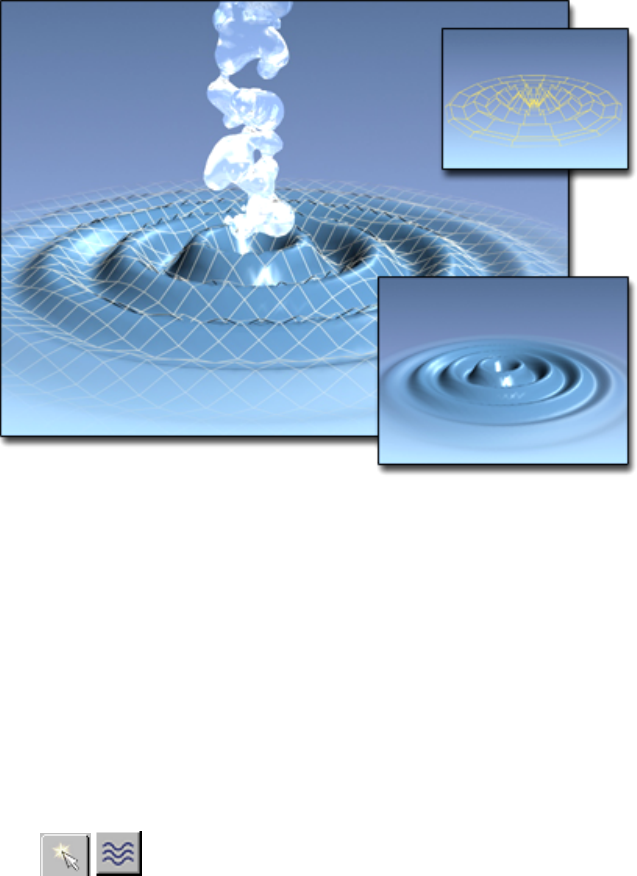
Using a ripple to deform a surface
The Ripple space warp creates a concentric ripple through world space. It
affects geometry and behaves the same as the Ripple modifier on page 1583 .
Use the Ripple space warp when you want the ripple to affect a large number
of objects, or to affect an object relative to its position in world space.
See also:
■Wave Space Warp on page 2695
Procedures
To create a Ripple space warp:
1 On the Create panel, click Space Warps. Choose
Geometric/Deformable from the list, then on the Object Type rollout,
click Ripple.
2Drag in a viewport to define the initial size of the ripple object icon.
The icon is displayed as a wireframe spider web.
2700 | Chapter 12 Space Warps and Particle Systems
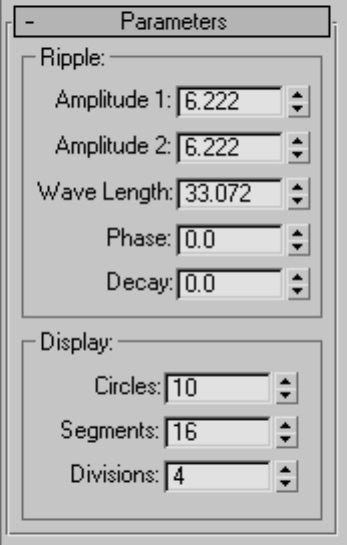
3Release the mouse button to set the icon size, and then move the mouse
to define the initial amplitude of the ripple wave.
4Click to set the wave amplitude.
Interface
The amplitude value set by dragging applies equally in all directions. The
ripple's Amplitude 1 and Amplitude 2 parameters are initially equal. Set these
parameters to unequal values to create a ripple whose amplitude varies relative
to the local X and Y axes of the space warp.
Ripple group
Amplitude 1 Sets ripple amplitude along the ripple warp object's local X axis.
Amplitude is expressed in active units.
Amplitude 2 Sets ripple amplitude along the ripple warp object's local Y axis.
Amplitude is expressed in active units.
Geometric/Deformable | 2701
Wave Length Sets the length of each wave, in active units.
Phase Offsets the phase of the wave from its origin at the ripple object's
center. Whole values have no effect; only fractional values do. Animating this
parameter makes the ripple appear to travel through space.
Decay When set to 0.0, the ripple has the same amplitude or amplitudes
throughout world space. Increasing the Decay value causes amplitude to
diminish as distance increases from the position of the ripple warp object.
Default=0.0.
Display group
The options control display of the Ripple warp object's icon. They don't change
the effect of the ripple.
Circles Sets the number of circles in the ripple icon.
Segments Sets the number of segments (pie slices) in the ripple icon.
Divisions Adjusts the size of the ripple icon without altering the ripple effect
as scaling would.
Flexibility parameter (Modify panel)
The Ripple space warp also has a Flexibility parameter that you can adjust
individually in each bound object's stack, at the Ripple Binding level. The
parameter belongs to each binding; it doesn't appear with the Ripple warp
parameters.
2702 | Chapter 12 Space Warps and Particle Systems
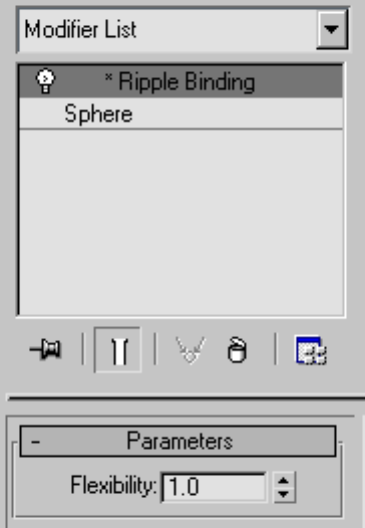
Flexibility Makes the bound object more or less responsive to the wave by
multiplying the amplitude by this value.
Conform Space Warp
Create panel > Space Warps > Geometric/Deformable > Object Type rollout >
Conform
Create menu > Space Warps > Geometric/Deformable > Conform
The Conform space warp modifies its bound object by pushing its vertices in
the direction indicated by the space warp icon, until they hit a specified target
object, or until the vertices move a specified distance from their original
position.
After creating a Conform space warp, you specify a target object in the Conform
parameters, and then bind the Conform to the object you want to deform.
You rotate the Conform icon to specify the travel direction (toward the target
object). The vertices of the deformed object move until they hit the target
object.
Geometric/Deformable | 2703
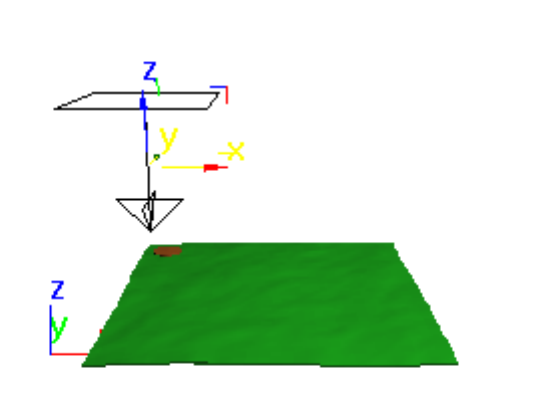
There is also a Conform compound object on page 660 that provides additional
methods of conforming one object to another.
Conform viewport icon (a surface is below it)
Procedures
Example: Using the Conform space warp:
Begin by making two objects.
1Create a terrain by making a wide, flat box with plenty of Length and
Width segments (or a quad patch). Apply a Noise modifier and adjust its
parameters to result in a bumpy terrain (not mountainous, but low and
irregular).
2Create a short, wide cylinder whose radius is about one-eighth the area
of the box (like a coin). You'll animate the cylinder to float diagonally
over the surface of the terrain.
3Set Cap Segments in the cylinder to 4, and position the cylinder to float
over the terrain.
4Set the object color of the cylinder to contrast with the color of the terrain.
5Move the cylinder inside one corner of the terrain as seen from the Top
viewport. Turn on Animate, move to frame 100, and move the cylinder
to the opposite corner of the terrain.
2704 | Chapter 12 Space Warps and Particle Systems
The coin/disk moves from one corner of the terrain to the other.
The terrain will become the target object, and the cylinder the deformed
object. The next step is to create the Conform space warp and bind it to the
cylinder.
1On the Create panel, choose Space Warps, and then, from the drop-down
list, choose Geometric/Deformable. Click the Conform button.
2In the Top viewport, in the center of the terrain, drag outward to create
the Conform space warp.
3Click the Pick Object button, and then click the terrain box.
4In the Front viewport, drag the space warp up until it's above the cylinder.
As seen in the Front viewport, the terrain is at the bottom, the cylinder
is between the terrain and the space warp, and the space warp is at the
top.
5Bind the space warp to the cylinder.
The cylinder becomes a disk that seems to be painted on the surface of
the terrain.
6Drag the time slider to see the cylinder/disk move across the box,
following the terrain.
Because the vertices are pushed almost to the level of the terrain, the faces of
the two object might intersect. In the following steps, you'll fix this by
adjusting the standoff distance between the target surface and the pushed
vertices. Then you'll go on to affect only selected vertices in the cylinder.
1Select the Conform space warp, and open the Modify panel.
2Set Standoff Distance to 3.
You can now clearly see the surface of the disk above the terrain.
3Set the Standoff Distance to 20.
The disk floats 20 units above the terrain. Next, change the affected
vertices.
4Select the disk/cylinder.
5In the modifier stack display, click the Cylinder item so it's highlighted
in gray.
6Apply a Mesh Select modifier.
Geometric/Deformable | 2705
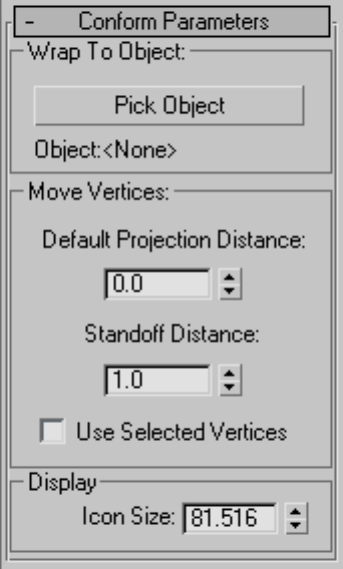
7At the Vertex sub-object level, in the Front viewport, region-select the
bottom cap vertices of the cylinder.
8Remain at the sub-object level, and in the stack display click the Conform
Binding item.
9In the viewport, select the Conform icon.
10 In the Modify panel, turn on Use Selected Vertices.
Now that only the bottom cap vertices are selected, the rest of the cylinder
is restored. If you adjust the viewing angle and play the animation, you'll
see that the bottom face of the cylinder follows the terrain, while the rest
of the cylinder retains its shape.
Interface
2706 | Chapter 12 Space Warps and Particle Systems
Wrap To Object group
These options provide controls to select the target object.
Pick Object Click this, and then select an object in the scene. The object you
select becomes the barrier against which the bound object's vertices will be
pushed.
Object Displays the name of the picked object.
Move Vertices group
These options affect how the vertices are moved.
Default Projection Distance The distance a vertex in the bound object moves
from its original location if it does not intersect the target object.
Standoff Distance The distance maintained between the vertex and the
surface of the target object. For example, if set to 5, the vertices can be pushed
no closer than 5 units from the surface of the target object.
Use Selected Vertices When on, only the sub-object selection of vertices on
the Stack are pushed. When off, all vertices in the object are pushed regardless
of the Stack selection.
Display group
Icon Size Specifies the size of the icon.
Bomb Space Warp
Create panel > Space Warps > Geometric/Deformable > Object Type rollout >
Bomb
Create menu > Space Warps > Geometric/Deformable > Bomb
The Bomb space warp explodes objects into their individual faces.
Geometric/Deformable | 2707
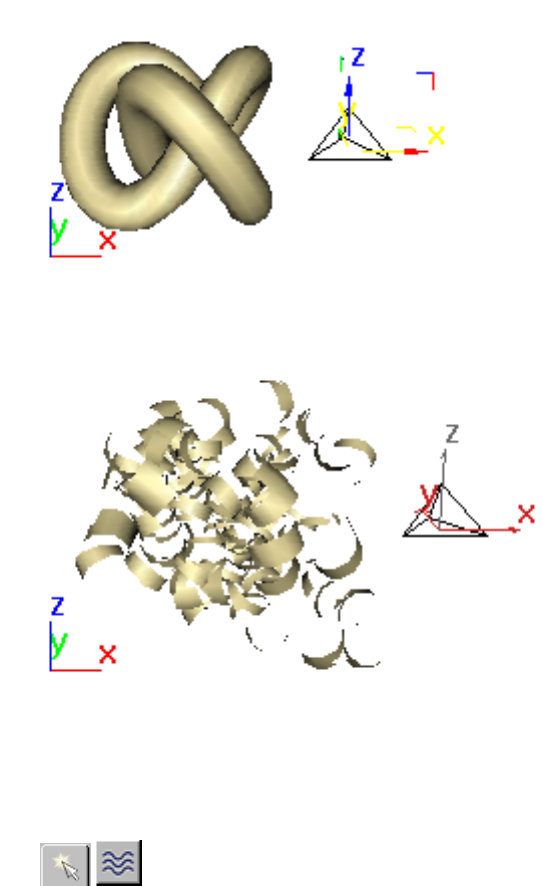
Right: Bomb viewport icon
Left: Torus knot
Effect of exploding the torus knot
Procedures
To create a Bomb space warp:
1 On the Create panel, click Space Warps. Choose
Geometric/Deformable from the list, and then on the Object Type rollout,
click Bomb.
2Create mesh objects to be exploded.
2708 | Chapter 12 Space Warps and Particle Systems
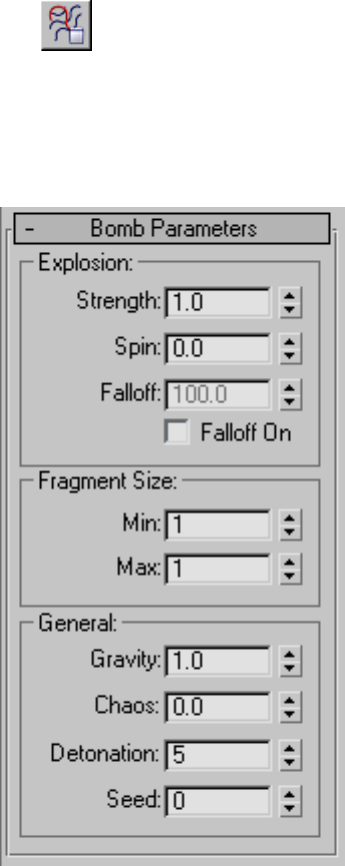
3 On the toolbar, click the Bind to Space Warp button.
4Drag the mouse between each object and the Bomb space warp.
5Adjust Bomb parameters to achieve different effects.
Interface
Explosion group
Strength Sets the power of the bomb. Larger values make the particles fly
farther. The closer an object is to the bomb, the greater the effect of the bomb.
Geometric/Deformable | 2709
Spin The rate at which fragments rotate, in revolutions per second. This is
also affected by the Chaos parameter (which causes different fragments to
rotate at different speeds), and by the Falloff parameter (which causes the
force of the explosion to be weaker the farther the fragment is from the bomb).
Falloff The distance from the bomb, in world units, of the effect of the bomb.
Fragments past this distance are not affected by the Strength and Spin settings,
but are affected by the Gravity setting.
For example, this is useful for blowing up the base of a building, and having
the top of the building topple. To see the effect, place a bomb at the base of
a tall cylinder with many height segments, and adjust Falloff to be less than
the height of the cylinder.
Falloff On Turn on to use the Falloff setting. The falloff range appears as a
yellow, tri-hooped sphere.
Fragment Size group
These two parameters define the number of faces per fragment. Any given
fragment will have a number of faces, randomly determined, between the
Min and Max values.
Min Specifies the minimum number of faces per fragment to be randomly
generated by the "explosion."
Max Specifies the maximum number of faces per fragment to be randomly
generated by the "explosion."
General group
Gravity Specifies the acceleration due to gravity. Note that gravity is always
in the direction of the world Z axis. You can have negative gravity.
Chaos Adds random variation to the explosion to make it less uniform. A
setting of 0.0 is totally uniform; 1.0 is a realistic setting. A value greater than
1.0 makes the explosion extra chaotic. Range=0.0 to 10.0.
Detonation Specifies the frame at which the bomb goes off. Bound objects
are unaffected before this time.
Seed Change to alter randomly generated numbers in the bomb. You can
achieve a different bomb effect by changing Seed while maintaining the other
settings.
Although you can animate strength and gravity, the equations used for
projectile motion assume they are constant. Therefore, the motion will not
2710 | Chapter 12 Space Warps and Particle Systems
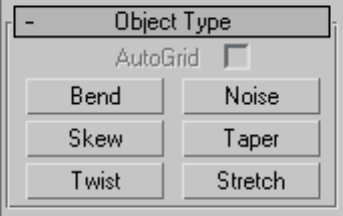
be physically correct, but it might look interesting. Also, if the bomb object
is in motion during the blast, the result is not physically correct.
Modifier-Based Space Warps
Create panel > Space Warps > Modifier-Based
Create menu > Space Warps > Modifier-Based
Modifier-based space warps duplicate the effects of standard object modifiers.
Like other space warps, they must be bound to objects, and they work in world
space. They are useful when you want to apply effects such as Twist or Bend
to a widely scattered group of objects.
Creating Modifier-Based Space Warps
You create modifier-based space warps the same way that you create other
space warps. Modifier-based space warps are listed on the Create panel as a
separate category under Space Warps.
All the modifier-based space warps use a box-shaped (nonrenderable) object.
When you create one, you use the mouse in the viewport as you do when
creating a Box primitive.
Unlike their modifier versions, these space warps do not have sub-object levels.
Modifier-Based Space Warps | 2711
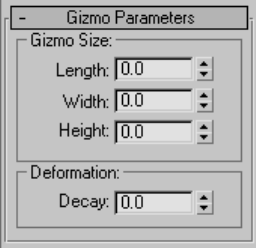
Interface
Gizmo Parameters rollout
Gizmo Size group
Length/Width/Height Let you adjust the warp object's dimensions.
Deformation group
Decay When is set to 0, there is no decay, and the space warp affects its
bound object regardless of its distance from the object. When you increase
the decay, the effect on the bound object falls off exponentially. See the topics
on the individual modifiers for more information.
Parameter rollout
The parameters for a modifier-based space warp are identical to those of the
modifier on which the space warp is based:
Bend Modifier on page 1139
Taper Modifier on page 1739
Noise Modifier on page 1501
Twist Modifier on page 1765
Skew Modifier on page 1596
Stretch Modifier on page 1681
2712 | Chapter 12 Space Warps and Particle Systems

Introduction to Particle Systems
Particle systems are useful for a variety of animation tasks. Primarily, they're
employed when animating a large number of small objects using procedural
methods; for instance, creating a snowstorm, a stream of water, or an explosion.
3ds Max provides two different types of particle systems: event-driven and
non-event-driven. The event-driven particle system, also known as Particle
Flow on page 2713 , tests particle properties, and, based on the test results, sends
them to different events. Each event assigns various attributes and behaviors
to the particles while they're in the event. In the non-event-driven systems
on page 2923 , particles typically exhibit similar properties throughout the
animation.
IMPORTANT Particle systems can involve a great many entities, each of which is
potentially subject to any number of complex calculations. For this reason, when
using them for advanced simulations, you should have a very fast computer and
as much memory as possible. Also, a powerful graphics card helps speed the
display of particle geometry in the viewports. Even so, it’s still easy to overburden
the system; if you encounter loss of responsiveness, wait for the particle system
to finish its calculations, and then reduce the number of particles in the system,
implement a cache, or use other methods to optimize performance.
Which Particle System to Use?
Having access to a wealth of particle systems in 3ds Max leads to the need to
decide which system to use for a particular application. In general, for a simple
animation, such as falling snow or a water fountain, setup is faster and easier
with a non-event-driven particle system. With more complex animations,
such as an explosion that generates different types of particles over time (for
example: fragments, fire, and smoke), use Particle Flow for greatest flexibility
and control.
Particle Flow
Particle Flow is a versatile, powerful particle system for 3ds Max. It employs
an event-driven model, using a special dialog called Particle View on page
2730 . In Particle View, you combine individual operators on page 7873 that
describe particle properties such as shape, speed, direction, and rotation over
a period of time into groups called events on page 7770 . Each operator provides
a set of parameters, many of which you can animate to change particle
Introduction to Particle Systems | 2713

behavior during the event. As the event transpires, Particle Flow continually
evaluates each operator in the list and updates the particle system accordingly.
To achieve more substantial changes in particle properties and behavior, you
can create a flow on page 7787 . The flow sends particles from event to event
using tests on page 7948 , which let you wire on page 7971 events together in
series. A test can check, for example, whether a particle has passed a certain
age, how fast it's moving, or whether it has collided with a deflector. Particles
that pass the test move on to the next event, while those that don't meet the
test criteria remain in the current event, possibly to undergo other tests.
NOTE Operators and tests are known collectively as actions on page 7701 .
Following are the principal sections in the Particle Flow documentation:
Using Particle Flow on page 2714
Particle Flow User Interface on page 2730
Actions on page 2758
The
ms-its:3dsmax_t.chm::/WSf742dab04106313315bef0fb112a19e466a-7ffb.htmParticle
Flow Tutorials .
See also:
■Non-Event-Driven Particle Systems on page 2923
How Particle Flow Works
Particle View on page 2730 is the primary interface for building and modifying
Particle Flow systems. The first event in the system is always a global event,
whose contents affect all particles in the system. It has the same name as the
Particle Flow source icon. By default, the global event contains a single Render
operator that specifies rendering properties for all particles in the system. You
can add other operators here to have them act globally, such as Material,
Display, and Speed. When you use an operator globally, be sure not to use
the same operator locally (that is, in any other events in the system) to avoid
potential conflicts.
The global event also serves as the Particle View representation of the particle
system. You can create a new system by duplicating this event, or by adding
an Empty Flow or Standard Flow. Conversely, if you clone the Particle Flow
2714 | Chapter 12 Space Warps and Particle Systems
icon in a viewport, or add a new PF Source, the new system appears in Particle
View as well.
The second event is called the birth event, because it must contain a Birth
operator. The Birth operator should exist at the top of the birth event, and in
no other place. The default birth event also contains a number of operators
that act locally to specify properties of particles while in that event. The default
particle system provides a basic global event and birth event that serve as a
useful starting point for creating your own system. If you like, you can instead
start with an empty system that lets you build a particle system from scratch.
Particle Flow | 2715
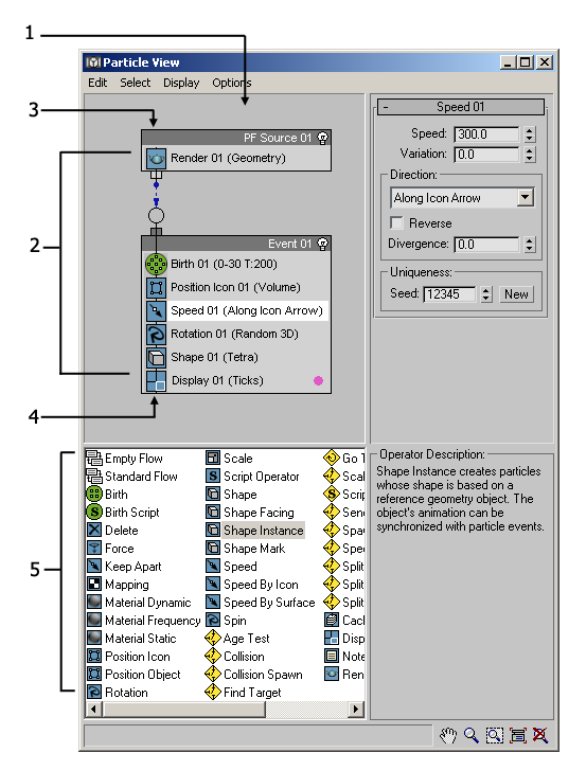
1. Event display
2. Particle diagram
3. Global event
4. Birth event
5. Depot
To add an action to the particle diagram, you drag it to the event display from
the depot (the area at the bottom of the Particle View dialog). If you drag an
2716 | Chapter 12 Space Warps and Particle Systems
action to an event, you can add it to the event or replace an existing action,
depending on where you drop it. If you drop it in an empty area, it creates a
new event. Then, to customize the action, you click its event entry, and then
edit its settings in the parameters panel at the side of Particle View.
To add complexity to the particle system, you can add a test to an event, and
then wire the test to another event. You can adjust the test parameters to
affect particle behavior, as well as determine whether specific conditions exist.
When particles meet these conditions, they become eligible for redirection to
the next event.
Particle Flow provides a number of tools for determining where in the system
particles currently reside, including the ability to change particle color and
shape on an event-by-event basis. You can also easily enable and disable
actions and events, and determine the number of particles in each event. To
speed up checking particle activity at different times during the animation,
you can cache particle motion in memory. Using these tools, plus the ability
to create custom actions with scripting, you can create particle systems of a
level of sophistication previously unachievable.
The Life of a Particle
Another way of looking at Particle Flow is from the perspective of an individual
particle. Each particle first comes into existence, or is born, via the Birth
operator on page 2764 , which lets you specify when to start and stop creating
particles, and how many to create.
The particles first appear at an object called an emitter. By default, the emitter
is the Particle Flow source icon using the Position Icon operator on page 2770
, but you can alternatively use the Position Object operator on page 2773 to
specify that particles should be born on the surface of or within any mesh
object in the scene.
After being born, particles can remain stationary at the emission point, or
start moving in two different ways. First, they can move, physically, within
the scene at a speed and in a direction specified by various actions. These are
typically Speed operators, but other actions can also affect particle motion,
including Spin on page 2783 and Find Target on page 2891 . In addition, you
can use the Force operator on page 2867 to affect their motion with outside
forces.
Particle Flow | 2717
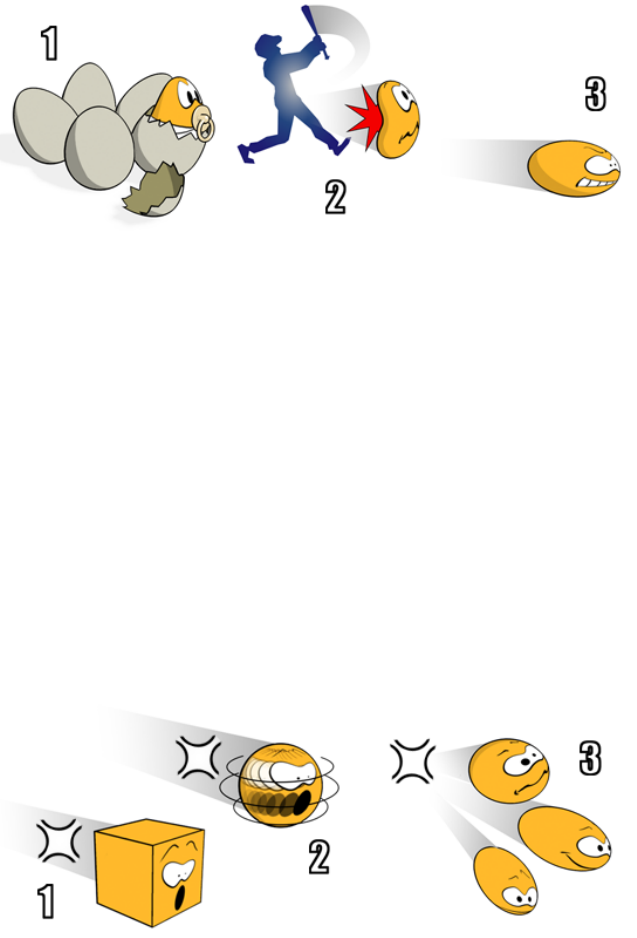
1. Particle immediately after creation, with no speed.
2. The Speed operator sets the particle in motion.
3. The particle continues moving until acted upon by another action.
The second way that particles move is logically, from event to event through
the particle diagram, as constructed in Particle View on page 2730 . Each event
can contain any number of operators that can affect, in addition to motion,
a particle's surface appearance, its shape and size, and others.
The particles start out in the birth event, which typically is the first event after
the global event. During a particle's residence in an event, Particle Flow
evaluates each of the event's actions from top to bottom, once per integration
step, and makes any applicable changes to the particle. If the event contains
a test, Particle Flow determines whether the particle tests True for the test's
parameters, such as whether it has collided with an object in the scene. If it
does, and if the test is wired to another event, Particle Flow sends the particle
to the next event. If it doesn't, the particle remains in the current event, and
may be further acted upon by its operators and tests. Thus, each particle exists
in only one event at a time.
An action in an event can change the particle shape (1), or the particle spin (2), or
spawn new particles (3).
2718 | Chapter 12 Space Warps and Particle Systems
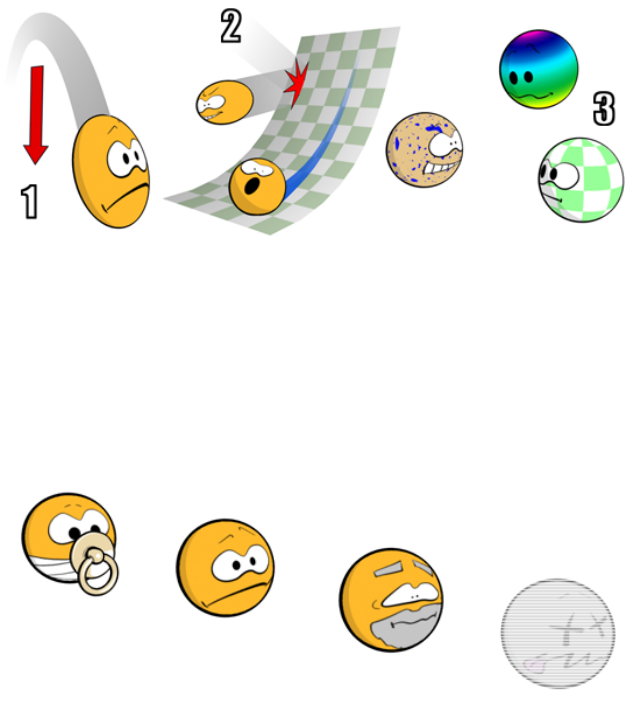
Actions can also apply forces to particles (1), specify collision effects (2), and alter
surface properties (3).
In this way, the particle continues to travel through the system. Due to the
flexible nature of schematic construction in Particle Flow, a particle may be
redirected to the same event several times. But at some point, you might want
the particle's life to end. For this purpose, you'd use the Delete operator on
page 2768 or the Collision Spawn test on page 2885 or Spawn test on page 2912 .
Otherwise, the particle lives throughout the entire animation.
Particle age can be used to kill a particle.
As a particle moves through the system, it's accompanied by a number of
channels. For example, each particle has a speed channel that defines how
fast it moves, and a material ID channel that lets Particle Flow know which
sub-material to apply to it. However, the material itself is not defined by a
channel, but by a Material operator that acts locally or globally. Properties
that are defined by channels persist, unless altered by an action. For example,
the Material Dynamic operator on page 2846 can change a particle's material
ID. In effect, by setting up a particle diagram and modifying how particles
look and act during the animation, you’re deciding how channel values change
based on events and animation keyframes.
Particle Flow | 2719
Particle Flow FAQ
This topic offers answers to a number of questions users commonly ask when
first learning to use Particle Flow. The first section contains links to all the
questions, and the subsequent sections contain the questions and answers
organized by category.
Question List
How does Particle Flow handle time? on page 2721
When I go to a different frame, the software sometimes seems to freeze for a
while. What's going on? on page 2722
Is there a way to pre-calculate portions of a particle simulation, as in "baking"
the animation? on page 2722
What else can I do to optimize performance? on page 2723
How do I use Particle Flow to make an object explode? on page 2723
How can I control the accuracy of the Particle Flow simulation? on page 2723
Can I use MAXScript to affect particles? on page 2723
Can I use more than one object as instanced geometry? on page 2724
How can I exclude particles from certain light sources? on page 2724
How do I open Particle View without clicking Particle View button on the
command panel? on page 2724
Do I need multiple Particle Views to manage more than one particle system?
on page 2724
Can I selectively disable or "turn off" portions of a particle system? on page
2724
I sometimes see events named “Action Recovery” in Particle View. Where did
they come from? on page 2725
How do I animate action parameters? on page 2725
How can I synchronize an animated bitmap texture to particle age? on page
2725
Do I still need to bind my Particle Flow particles to space warps? on page 2725
How do I make particles follow a path? on page 2725
Can I use Snapshot or dynamics with Particle Flow? on page 2726
2720 | Chapter 12 Space Warps and Particle Systems
How do I use motion blur with Particle Flow? on page 2726
How do I use the Particle Age and Particle MBlur maps with Particle Flow? on
page 2726
I’m trying to apply Particle Flow to an animation created with a dynamics
system. Why am I getting strange results such as unexpected spawning of
particles? on page 2727
How can I make all particles appear in the first frame while giving them
different ages? on page 2727
How can I specify the time frame in which animated parameters are applied
to particles? on page 2727
How can I apply bubble motion to particles? on page 2727
How can I branch an event to several other events? on page 2728
Does it matter which order I put actions in an event? on page 2728
How can I tell which particles are in a certain event? on page 2729
Why do my particles lose their material when they move to another event?
on page 2729
Can I have an event receive input from multiple events? on page 2729
I changed an operator setting, but it doesn't seem to have any effect on the
particle system. on page 2729
Can an event be isolated in Particle View and not connected to anything? on
page 2730
General
How does Particle Flow handle time?
Parameters that measure time in Particle Flow, such as Birth on page 2764 >
Emit Start/Stop and Age Test on page 2879 > Test Value, are specified in frames.
However, Particle Flow is always aware of the current system frame rate (fps),
and if you change this rate, it adjusts all time-related parameters to keep the
same timing. For instance, if you set Test Value to 60 when you're using the
NTSC frame rate (30 fps), and then switch to PAL (25 fps), Particle Flow
automatically changes the value to 50, so the age that's tested for is still two
seconds.
On the other hand, rate parameters, such as Speed, are measured in units per
second, so they don't change when you go to a different frame rate.
Particle Flow | 2721

When I go to a different frame, the software sometimes seems to
freeze for a while.What's going on?
Most of the animation in Particle Flow is history dependent; that is, to be able
to draw the particles in a particular frame, the program needs to know what
happened in all previous frames. Normally, when you change a parameter
value, the program needs to recalculate all frames between the start and the
current frames. Or, if you go to a different frame, Particle Flow must recalculate
one or more animation frames. If you go forward, it must calculate the frames
between the current frame and the one you go to. So, for example, if you just
go to the next frame, relatively little calculation is needed. But if you go
backward, even only by one frame, it must calculate all frames from the start
of the animation to the frame you go to.
If a lot of calculation is needed, there is a delay. Meanwhile, the software
displays a message like “PF Source 01 Update xx% (Press Esc to cancel)” in the
status bar, so you can get an idea of how the recalculation is progressing. If,
when you see this message, you press the Esc key, Particle Flow displays an
alert with the message “Click OK to turn off PF Source 01.” If you click OK,
the recalculation stops, giving you the opportunity to optimize the animation.
For example, you could reduce the number of particles for testing purposes.
You must turn the source back on to continue. If you click Cancel, the
calculation continues.
TIP An easy way to speed up recalculation and rendering of particles is by adjusting
the total number of particles. To do this, select the Particle Flow source icon, and
then go to the Modify panel > Emission rollout > Quantity Multiplier group. Here
you can increase or decrease by percentage the total number of particles, separately
for viewport display and rendering.
TIP To speed up animation playback when you're not adjusting parameters, use
the Cache operator (see the following item).
Is there a way to pre-calculate portions of a particle simulation, as in
"baking" the animation?
Yes. Particle Flow's Cache operator on page 2856 lets you store all or part of a
particle animation in memory, and then play back the animation from memory
rather than having to recalculate particle motion. This makes it much faster
to jump between different parts of the animation. You can even save the
cached animation to disk as part of the scene file.
2722 | Chapter 12 Space Warps and Particle Systems
What else can I do to optimize performance?
Particle Flow can place heavy processing and resource demands on your
computer. For optimal performance, the most important thing you can do is
to use the fastest available CPU. Also, when using particle systems with many
particles, install as much memory as possible in your computer, especially if
you're using caching.
Other ways to improve performance include reducing the percentage of
viewport particles with the Quantity Multiplier setting, and temporarily
disabling flows and actions that you're not currently working with. When
making parameter changes, return to the first frame and play forward, or set
Particle View > Options menu > Update Type to “Forward”. That way, if you
change a setting, the particle system is not forced to recalculate its state from
the very beginning. The change will affect only animation from the current
frame forward. On the other hand, the result could be misleading, because
you won’t be able to see the difference right away.
Also, be cautious when using spawning; it can quickly create very large
numbers of particles, especially when you use the By Travel Distance option
in the Spawn test on page 2912 .
How do I use Particle Flow to make an object explode?
Particle Flow doesn't have a fragmentation operator, but by utilizing PArray
in a Birth Script operator, you can implement fragmentation in Particle Flow.
You can find an example scene, with a commented script operator, in the file
scriptfragmentationwithcache.max, on the install disc in the directory
Samples\Scenes\Version6Features\Scenes\Particle Flow\Fragments.
How can I control the accuracy of the Particle Flow simulation?
On the command panel > System Management rollout on page 2754 of the PF
Source icon, you can adjust the integration step independently for viewport
playback and rendering. The smaller the integration step, the more times
Particle Flow calculates particle motion per frame, resulting in greater accuracy
at the cost of calculation time.
Can I use MAXScript to affect particles?
Yes. Particle Flow includes a Script operator on page 2874 and test on page 2911
, as well as a Birth Script operator on page 2767 , that let you fully customize
the particle system. Each scriptable action includes a sample script, which also
lists all relevant scriptable functions. You can also control parameters of the
Particle Flow | 2723

Force operator on page 2867 and Keep Apart operator on page 2815 with script
wiring, described in the respective topics.
In addition, you can execute a script at each integration step, and another
just before each frame is viewed or rendered; see Script rollout on page 2756 .
Can I use more than one object as instanced geometry?
Yes. With the Shape Instance operator on page 2825 , you can use groups,
hierarchies, and objects consisting of multiple elements, with each members
of the combined object constituting a separate particle. These objects can be
emitted in a specific order, or in a random order. For example, you can use a
text object, with the letters emitted in the order in which they appear in the
text.
How can I exclude particles from certain light sources?
To prevent particles from being affected by a light source, use the light’s
Exclude function, found on the General Parameters rollout (Modify panel),
to specify any events containing particles to be excluded. Specifying the PF
Source XX object (default name) has no effect; you must specify all objects
listed as PF Source XX->Event XX.
Particle View
How do I open Particle View without clicking Particle View button on
the command panel?
Press the 6 key. It might be necessary to first turn on the Keyboard
Shortcut Override Toggle.
Do I need multiple Particle Views to manage more than one particle
system?
No: All particle systems appear in Particle View. You can scroll and zoom the
event display to see the different systems.
Can I selectively disable or "turn off" portions of a particle system?
Yes. Particle View gives you a number of different ways of doing this. You can
click an action's icon or an event's light-bulb icon to turn it off, or use the
right-click menu, or use Edit menu's Turn On and Turn Off commands. Also,
2724 | Chapter 12 Space Warps and Particle Systems

if you press Esc while Particle Flow is calculating, the software gives you the
opportunity of turning off the entire particle system, thus immediately
returning control of the software to you. You can then analyze the system to
determine the area of slowdown, optimize or simplify the particle flow, and
then recalculate the animation.
I sometimes see events named “Action Recovery” in Particle View.
Where did they come from?
When you merge a scene containing Particle Flow data, you can import entire
events and isolated actions. If you merge an action without its events, the
software places it in an event named “Action Recovery.”
Animation
How do I animate action parameters?
Use the same Auto Key on page 3007 method as with animating any other
parameter in 3ds Max.
NOTE Avoid animating Particle Flow parameters with Set Key mode or with
Shift+right-click. Also, to see animation keys for actions in the track bar, make sure
the Particle Flow source icon is selected.
How can I synchronize an animated bitmap texture to particle age?
Use the Material Dynamic operator on page 2846 in conjunction with the
Bitmap 2D map on page 5633 . You'll find a procedure that describes the method
in detail here on page ? .
Do I still need to bind my Particle Flow particles to space warps?
No; you use the Collision test on page 2881 , Collision Spawn test on page 2885
, or Force operator on page 2867 to affect particle motion with 3ds Max space
warps. The ability to do this on a global and local (per-event) basis gives you
much greater control over how space warps affect the particles than with
previous systems.
How do I make particles follow a path?
You can use the Speed By Icon operator on page 2796 or the Find Target test
on page 2891 , assigning the icon or target to a spline path. You'll find illustrative
procedures in both topics.
Particle Flow | 2725
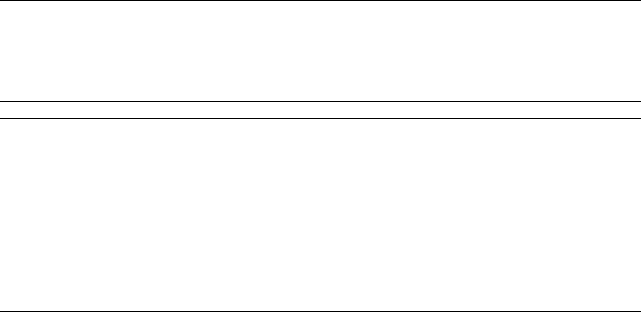
Can I use Snapshot or dynamics with Particle Flow?
No. The Snapshot tool is not currently compatible with Particle Flow, nor is
reactor or the legacy dynamics system.
How do I use motion blur with Particle Flow?
You can apply motion blur on a per-event basis by editing the event's object
properties on page 245 with the right-click menu in Particle View, or on a
global basis by editing the global event's object properties. In the Particle View
dialog, highlight the event to edit and then right-click and choose Properties.
On the Object Properties dialog, edit the Motion Blur group settings.
Alternatively, you can apply motion blur to an entire Particle Flow system
without the need to set properties by using the multi-pass motion blur effect
on page 5147 with a camera.
NOTE You can also use Object Properties to set other properties for events and
the particle system, as with any object in 3ds Max. Do this only within Particle
View , not using the source icon in the viewports (right-click menu > Properties or
Edit menu > Object Properties).
NOTE When using Object Motion Blur, if an event contains a Material Dynamic
operator that uses a material with a Particle Age, Particle MBlur, or Bitmap map,
the event should not also contain a Delete operator, or a Spawn or Collision Spawn
test. Also, the event should not contain any tests that are wired to another event.
The only exception to this is the Age Test operator when set to Absolute Time
without any variation; that is, all particles leave the event at the same time. This
applies to the use of Object Motion Blur only; there are no restrictions with Image
Motion Blur.
How do I use the Particle Age and Particle MBlur maps with Particle
Flow?
To use the Particle Age map with Particle Flow, you must use the Delete
operator to give the particles a finite life span. For further information, see
Delete Operator on page 2768 .
Also note the following:
■Particle Age, Particle MBlur and a Bitmap map containing an animated
bitmap can be used only with Material Dynamic operator on page 2846 ,
with Same As Particle ID turned on. You'll find procedures for using Bitmap
and Particle Age at this topic.
2726 | Chapter 12 Space Warps and Particle Systems
■The particle material cannot be a submaterial; it must be the main material.
■In the non-event-driven particle systems in 3ds Max, Particle MBlur is used
with a control named Direction Of Travel\MBlur and an accompanying
Stretch parameter. In Particle Flow, you can replicate the stretching effect
by using a Scale operator, turning off Scale Factor > Constrain Properties,
and scaling the particle along one axis.
I’m trying to apply Particle Flow to an animation created with a
dynamics system.Why am I getting strange results such as unexpected
spawning of particles?
The dynamics system probably generates rotation keys using the Euler XYZ
controller. To avoid interpolation discontinuities, change the rotation
controller for such objects to TCB Rotation.
How can I make all particles appear in the first frame while giving
them different ages?
Use a negative frame range in the Birth operator on page 2764 . For example,
to get a particle-age spread of 30 frames, set Emit Start to -29 and Emit Stop
to 0.
How can I specify the time frame in which animated parameters are
applied to particles?
You can animate many of the Particle Flow parameter values with keyframing.
In most actions, you can choose the time frame by which to apply this
animation to the particles from a drop-down list labeled Sync By. You can
apply this animation to particles in the time frame of the entire animation,
or at a specific time of each particle's life (particle age), or based on the length
of time the particle has been in the current event. See the individual operator
and test topics for details.
How can I apply bubble motion to particles?
Although Particle Flow doesn't have the bubble motion option on page 2991
found in PArray, you can simulate the effect by following this procedure:
1Add an object to serve as particle geometry and a dummy helper object
on page 2531 .
2Position the dummy away from the center of the particle geometry object
and link on page 3267 your particle geometry to the dummy so that the
Particle Flow | 2727
dummy is the parent object (that is, drag from the geometry object to
the dummy). The distance between the pivots on page 3398 of the two
objects determines the radius of the bubble motion.
3In Particle View, add a Shape Instance operator on page 2825 and a Spin
operator on page 2783 to the event in which the bubble motion is to occur.
4Click the Shape Instance operator and specify the dummy object as the
particle geometry object.
5Click the Spin operator and set appropriate values for Spin Rate and
Variation. For Spin Axis, keep the default setting of Random 3D.
The result is particle motion in which the particles bob about while moving
along their paths, similar to bubble motion.
Events
How can I branch an event to several other events?
Particle Flow includes several Split tests, which let you send some particles to
another event based on quantity, selection, or source. You can use any number
of these in a single event to send parts of the particle stream to different events,
and then use a Send Out test on page 2912 to redirect the remaining particles
to another event. Keep in mind that any tests subsequent to the first can work
only with particles remaining in the event, not necessarily all particles that
begin in the event.
Does it matter which order I put actions in an event?
It depends. If an event contains two or more operators of the same type, such
as Shape, the last one overrides the rest. If an event contains two or more tests,
they are evaluated and particles redirected in the order in which the tests
appear.
However, if two actions in an event control the same properties, the interaction
is more complex. An action that works on a continuous basis will typically
prevail over one that affects particles only when they first enter the event. For
example, both the Find Target test on page 2891 and Speed operator on page
2791 can control particle speed and direction, but the test works continuously,
while the operator takes effect only once. If an event contains both, particle
speed and direction will be primarily controlled by the test, in general, even
if the operator comes after the test. However, the operator's settings will still
have some influence over particle behavior, particularly if its Speed value is
2728 | Chapter 12 Space Warps and Particle Systems
significantly higher than that of the test. For a list of actions’ effective time
frames, see Action Time Frames on page 2759 .
Also, if you're testing for a specific condition that can be affected by other
actions in an event, be sure to place the test after the actions. For example, in
an event with a Force operator on page 2867 and a Collision test on page 2881
, place the Collision test after the Force operator. This avoids the possibility
of the force pushing particles past the deflector before the software can test
for the collision, which would allow the particles to penetrate the deflector.
In general, place tests at the end of the event.
How can I tell which particles are in a certain event?
One way is to set the Type option for the Display operator on page 2864 in
each event to a different choice. For example, the first event could use Ticks,
the second Circles, and the third Lines. This way the particles change
appearance in the viewports as they move from event to event. You can also
use the Display operator to change particle colors, to further distinguish them.
Another way is to select all particles in a certain event. Select the Particle Flow
source icon, and then go to the Modify panel > Selection rollout and click the
Event icon. You can then click an event in the Select By Event list to highlight
all of its particles in the viewports.
Why do my particles lose their material when they move to another
event?
A material is a static property of an event. It does not travel along with the
particles from event to event. A particle's material ID does, but its material
does not. If you want particles always to use the same material, define the
material in the global event on page 7801 with a Material operator on page
2839 or a Shape Instance operator on page 2825 . Otherwise, you need to define
it in each local event.
Can I have an event receive input from multiple events?
Particle Flow lets you wire any number of tests to a single event.
I changed an operator setting, but it doesn't seem to have any effect
on the particle system.
A similar operator in the global event might be overriding your local operator.
By default, Particle Flow evaluates local operators first, and then global
operators. If a global operator affects the same property, such as speed, as a
Particle Flow | 2729
local one, the particle system will use the value set by the global operator.
You can set local operators to override global ones by choosing Particle View
> Options menu > Action Order > Globals First.
Can an event be isolated in Particle View and not connected to
anything?
Yes, but it won't affect the particle system at all.
Particle Flow User Interface
Particle View
Select a Particle Flow source icon > Modify panel > Setup rollout > Click Particle
View (or press 6).
Create panel > Geometry > Particle Systems > Object Type rollout > Click PF
Source. > Setup rollout > Click Particle View (or press 6).
Particle View provides the main user interface for creating and modifying
particle systems in Particle Flow. The main window, known as the event display,
contains the particle diagram, which describes the particle system. A particle
system consists of one or more events wired together, each of which contains
a list of one or more operators on page 2761 and tests on page 2877 . Operators
and tests are known collectively as actions.
The first event is called the global event, because any operators it contains can
affect the entire particle system. The global event always has the same name
as the Particle Flow icon; by default, this is PF Source ## (starting with 01 and
counting upward). Following this is the birth event, which must contain a
Birth operator on page 2764 if the system is to generate particles. By default,
the birth event contains this operator as well as several others that define the
system's initial properties. You can add any number of subsequent events to
a particle system; collectively, the birth event and additional events are called
local events. They're called this because a local event's actions typically affect
only particles currently in the event.
You use tests to determine when particles are eligible to leave the current
event and enter a different one. To indicate where they should go next, you
wire the test to another event. This wiring defines the schematic, or flow, of
the particle system.
2730 | Chapter 12 Space Warps and Particle Systems
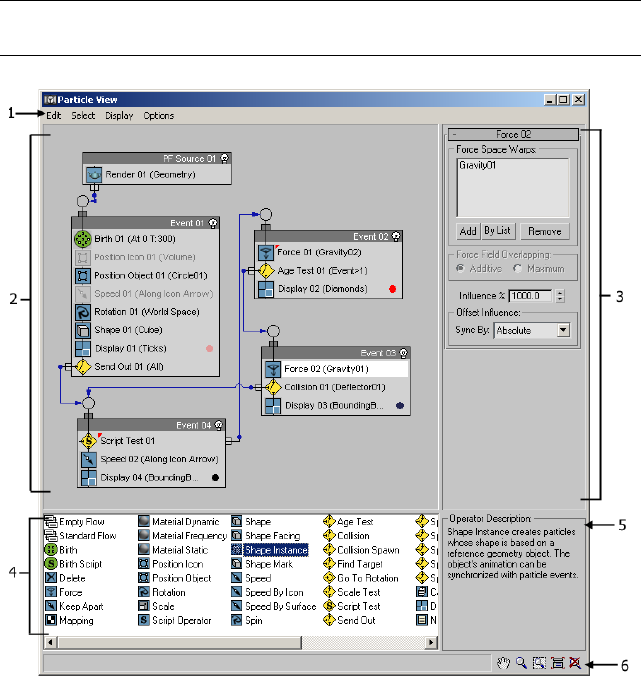
By default, the name of each operator and test in an event is followed by its
most important setting or settings in parentheses. Above the event display is
a menu bar, and below is the depot, containing all actions available for use in
the particle system, as well as a selection of default particle systems.
TIP The easiest way to open Particle View is by pressing the 6 key. It's not necessary
to first select a Particle Flow icon.
1. Menu bar
2. Event display
3. Parameters panel
4. Depot
5. Description panel
6. Display tools
Particle Flow | 2731
Particle View comprises the following elements:
■The menu bar on page 2732 provides functions for editing, selection,
adjusting the view, and analyzing the particle system.
■The event display on page 2741 contains the particle diagram, and provides
functions for modifying the particle system.
■The parameters panel contains rollouts for viewing and editing parameters
of any selected actions. Basic functionality is identical to that of rollouts
on the 3ds Max command panels, including usage of the right-click menu.
To toggle display of the parameters panel, choose Display menu >
Parameters.
■The depot contains all Particle Flow actions, as well as several default particle
systems. To see an item's description, click its entry in the depot. To use
an item, drag it into the event display on page 2741 .
The contents of the depot fall into three categories: operators on page 2761
, tests on page 2877 , and flows on page 2875 .
To toggle display of the depot, choose Display menu > Depot.
■The Description panel displays a brief description of the highlighted depot
item.
To toggle display of the description panel, choose Display menu >
Description.
■The icon-based display tools in the bottom-right corner of the Particle View
dialog let you pan and zoom the event display window. For descriptions,
see Display menu on page 2738 .
Particle View Menu Bar
Select a Particle Flow source icon. > Modify panel > Setup rollout > Click
Particle View (or press 6).
Create panel > Geometry > Particle Systems > Object Type rollout > Click PF
Source. > Setup rollout > Click Particle View (or press 6).
The menu bar provides access to a number of important Particle View
functions.
2732 | Chapter 12 Space Warps and Particle Systems

Procedures
To render only particles in specific events:
1In Particle View, highlight the events containing the particles you want
to render.
2Choose Select menu > Assign Selection To Viewport.
3Render using one of the Render Type on page 5900 > Selected options.
To bring a Particle Flow setup into a different scene:
1In Particle View, highlight the events containing the particles you want
to merge with a different scene. For example, to designate only a particular
flow, you might highlight its global event, and then choose Select menu
> Select Downstreams.
2Choose Select menu > Save Selected, and use the file dialog to specify a
file to save.
NOTE Any scene objects on which Particle Flow depends are also saved. For
instance, if a Shape Instance operator on page 2825 in one of the highlighted
events refers to a certain object, that object is saved along with the designated
events.
3Open or create the scene with which the saved Particle Flow setup will
be combined, and then use Merge on page 6854 to merge the file from
step 2.
Particle Flow | 2733
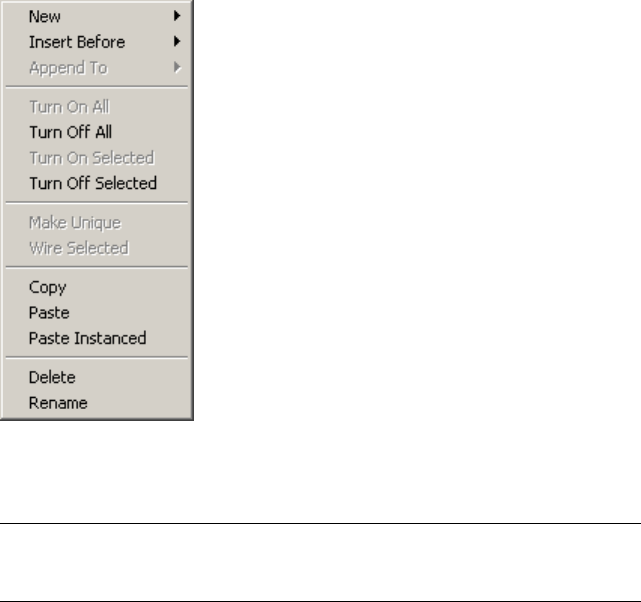
Interface
Edit menu
Each of the first three commands on this menu presents a submenu containing
all actions. Choose the command, and then choose an action from the
submenu.
NOTE The Undo and Redo commands are available from the main 3ds Max Edit
menu, and their default keyboard shortcuts are the same: Ctrl+Z and Ctrl+Y,
respectively.
New Adds a new event containing the chosen action to the event display.
Insert Before Inserts the chosen item above each highlighted action. Available
only when one or more actions are highlighted.
Append To Inserts the chosen item at then end of each highlighted event.
Available only when one or more events are highlighted.
Turn On All Turns on all actions and events.
Turn Off All Turns off all actions and events.
Turn On Selected Turns on any highlighted, turned-off actions or events.
Available only when one or more highlighted items are turned off.
2734 | Chapter 12 Space Warps and Particle Systems
Turn Off Selected Turns off any highlighted, turned-on actions or events.
Available only when one or more highlighted items are turned on.
Make Unique Converts an instanced action to a copy that's unique to its
event. Available only when one or more instanced actions are highlighted.
Wire Selected Wires one or more highlighted tests to a highlighted event,
or one or more highlighted global events to a highlighted birth event. Available
only when one or more tests and a single event are highlighted, or when one
or more global events and a single birth event are highlighted.
Copy Copies any highlighted events, actions, and wires to the paste buffer.
Keyboard equivalent: Ctrl+C.
Paste Pastes the contents of the paste buffer to the event display. Keyboard
equivalent: Ctrl+V.
The result of copying and then pasting multiple items depends on what you
copied:
■If you copied multiple actions, pasting adds them all to a single new event,
even if they originally came from different events.
■Copying multiple events or wires pastes them exactly as copied.
■If you copied a combination of actions and events, pasting creates a new
event for each group of actions from a single event. For example, if you
highlight event A, some actions from event B, and some actions from event
C, copying and then pasting would add three events: a copy of event A, a
second event with the actions from event B, and a third event with the
actions from event C.
Paste Instanced Pastes the contents of the paste buffer to the event display,
making instances of any pasted actions and their originals.
For the results of pasting multiple copied items, see Paste, above.
Delete Deletes any highlighted items. Keyboard equivalent: Delete.
Deleting an event also deletes all of its actions.
Rename Lets you enter a new name for any single highlighted item in the
event display. Available only when one action or test is highlighted
Particle Flow | 2735
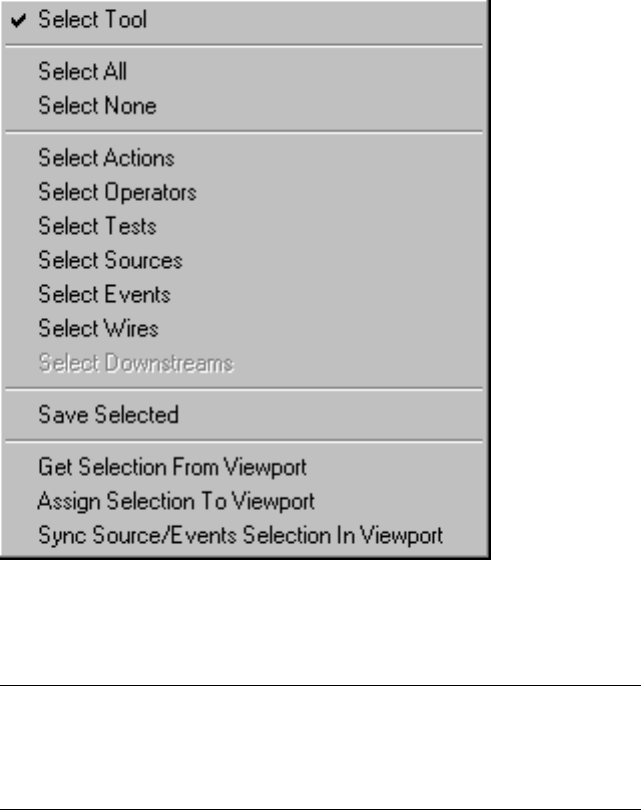
Select menu
By default, the Select tool is active when Particle View is open, as indicated
by the arrow-shaped mouse cursor. You can use this tool to highlight, move,
and copy events, actions, tools, and wires. You can also use the commands
on this menu to highlight all elements, no elements, or elements by category.
NOTE When you render using any of the Selected options, the software renders
only events that are selected in the viewports. You can use the last three commands
on this menu to manage and coordinate selection of events and flows between
Particle View and the viewports. This also applies to use of the Views menu > Shade
Selected command.
Select Tool Activates the Select tool. Choose this to return to the Select tool
after using interactive tools for panning and zooming the event display.
Alternatively, simply right-click anywhere in the event display to activate the
Select tool.
Select All Highlights all items in the event display.
2736 | Chapter 12 Space Warps and Particle Systems

Select None Deselects all items in the event display. Alternatively, click an
empty area in the event display.
Select Actions Highlights all operators and tests in the event display.
Select Operators Highlights all operators in the event display.
Select Tests Highlights all tests in the event display.
Select Events Highlights all events in the event display.
Select Wires Highlights all wires in the event display.
Select Downstreams Highlights all events after currently highlighted events.
Available only when one or more events are highlighted.
Save Selected Saves only highlighted elements in the event display to a .max
file. You can then open this file, or combine it with an existing scene with
File menu > Merge.
NOTE The Particle View > Save Selected command saves all items selected in
Particle View and in the scene. So if a PF Source icon is selected in the scene,
then this command will save its global event as well as any birth events associated
with it. if you want to save only parts of a Particle Flow setup, first unselect
everything in the scene.
Also, if an action references an object (for example, a Shape Instance operator
on page 2825 uses a geometry object), and the action or its parent event is
highlighted when you use Save Selected, then the reference object is saved as
well.
Get Selection From Viewport Highlights global events whose source icons
are selected in the viewports.
Assign Selection To Viewport Transfers an event selection to the viewports.
Use this to render only particles in specific events. First, in Particle View,
highlight the events to render. Next, choose this command, and finally, render
using one of the Render Type on page 5900 > Selected options.
Sync Source/Events Selection In Viewport Selects all events of any source
icons selected in the viewports. You can then propagate this selection to
Particle View with the Get Selection From Viewport command.
Use this function to render a specific particle flow using one of the Render >
Selected options.
Particle Flow | 2737

Display menu
The first five commands on this menu are also available as icons, in the Display
tools section on the right side of the bottom border of the Particle View dialog.
Each command's Display tools icon is shown below.
Pan Tool Drag in the event display to move the view. The mouse cursor
changes to a hand icon. You can also pan the view by dragging with the middle
mouse button or wheel button held down.
To exit this mode, right-click in the event view or choose the command again.
Zoom Tool Drag in the event display to zoom the view. The mouse
cursor changes to a magnifying-glass icon. Drag upward to zoom in, or
downward to zoom out.
To exit this mode, right-click in the event view or choose the command again.
Zoom Region Tool Drag in the event display to define a zoom rectangle.
The mouse cursor changes to the image of a magnifying glass inside a zoom
region. When you release the mouse button, the display zooms to show only
the area defined by the region.
To exit this mode, right-click in the event view or choose the command again.
Zoom Extents Sets the zoom to show the entire particle diagram in
the event display.
2738 | Chapter 12 Space Warps and Particle Systems
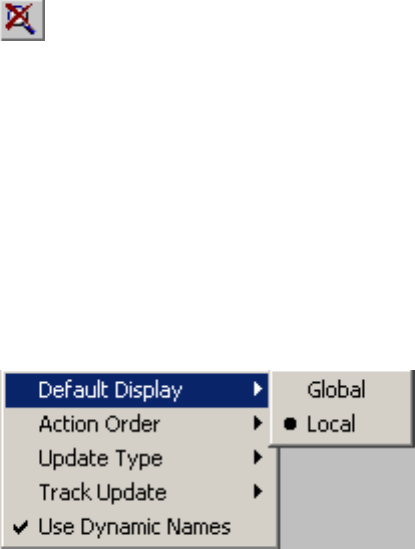
No Zoom Sets the zoom to the default level. This is the level displayed
when you first open Particle View in a given session.
Parameters Toggles display of the parameters panel, on the right side of the
Particle View dialog. Default=on.
Depot Toggles display of the depot, below the Particle View dialog.
Default=on.
Description Toggles the Description panel, to the right of the depot.
Default=on.
The Description panel displays a brief description of any action highlighted
in the depot.
Options menu
This menu contains a number of options useful in analyzing and debugging
particle systems.
Default Display Determines whether the Display operator is applied locally
or globally to new particle systems and events. Default=Local.
■Global When you create a new particle system, Particle Flow adds a single
Display operator to the global event. It does not add a Display operator to
each new event.
■Local Particle Flow adds a Display operator to each new event. This lets
you easily distinguish particles in different events in the viewports.
Action Order For predictable results, don't use similar actions in the global
and local events. However, if comparable actions do exist in both the global
event and other events, Particle Flow applies them to the system in the order
specified here. Typically, the effect that's applied last is the one that's visible
in the particle system. Default=Locals First.
Particle Flow | 2739
For example, consider a situation in which the global event contains a Shape
operator set to Cube, and the other events in the same system contain Shape
operators set to Tetra or Sphere. By default, Particle Flow applies the global
Shape operator last at each integration step, overwriting any local shapes, so
all particles would be cubes. But if you set Action Order to Globals First, the
local shapes are applied last, and particles appear as tetrahedrons or spheres,
depending on which event they're in.
■Globals First At each integration step, Particle Flow first applies actions
in the global event, and then actions in the other (local) events. Typically,
the result is that actions in the local events override comparable actions
in the global event.
■Locals First At each integration step, Particle Flow first applies actions in
the local events, and then actions in the global event. Typically, the result
is that actions in the global event override comparable actions in the local
events.
Update Type This setting determines how Particle Flow updates the system
when you change a parameter during playback. Because the state of the particle
system at any given frame can depend on events in previous frames, using
the Complete option can provide a more accurate depiction of the result of
the change, at a cost in speed; it takes more time to recalculate the entire
system starting at the first frame. Default=Complete.
■Complete When you change a setting during playback, Particle Flow
updates the entire system, starting at the first frame.
■Forward When you change a setting during playback, Particle Flow
updates the system starting at the current frame.
Track Update Provides options for visualizing the particle system status in
Particle View.
■Particle Count Adds a tab above each event that shows the number of
particles in the event. The global event's count shows the total number of
particles in the particle system.
Use this, in addition to the ability to display particles differently in each
event, to trace particle progress through the system.
■Update Progress Highlights each action in color whenever Particle Flow
evaluates it.
The highlighting is very fast, but this option can add significant
computational overhead to the particle system, with the result that
2740 | Chapter 12 Space Warps and Particle Systems
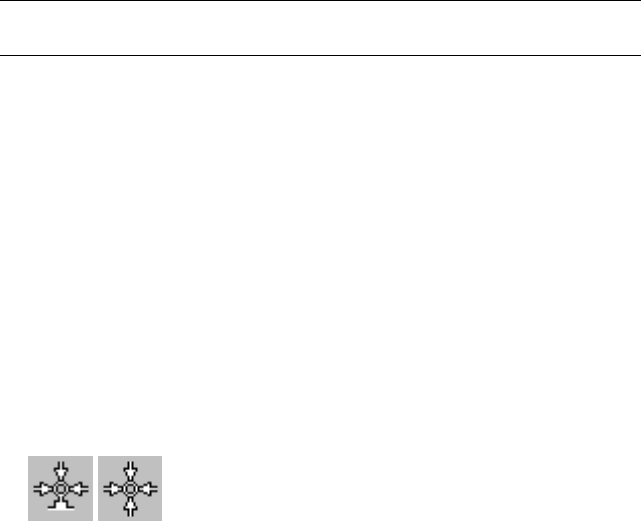
real-time playback might skip a greater number of frames. To see all frames,
turn off Time Configuration > Real Time.
Use Dynamic Names When on, action names in events are followed by their
most important setting or settings, in parentheses. When off, only the names
appear. Default=on.
Particle View Event Display
Select a Particle Flow source icon. > Modify panel > Setup rollout > Click
Particle View (or press 6).
Create panel > Geometry > Particle Systems > Object Type rollout > Click PF
Source. > Setup rollout > Click Particle View (or press 6).
The event display on page 7772 in Particle View contains the particle diagram,
and provides a complete range of intuitive functions for editing the particle
system.
NOTE A number of these functions are also available from the event display
right-click menu on page 2745 , as well as the menu bar on page 2732 .
Editing the Particle Diagram and Particle System
Interactive functionality in event display includes the following:
General
■To add an action to the particle system, drag it from the depot to the event
display. If you drop it in an empty area of the event display, it creates a
new event. If you drag it to an existing event, the result depends on whether
a red line or a blue line appears when you drop it. If a red line, the new
action replaces the underlying action. If a blue line, the action is inserted
in the list.
■To edit an action's parameters, click its name in an event. The parameters
appear on the right side of Particle View. If not, it means the parameters
panel is hidden; to display it, choose Display menu > Parameters.
■ To wire a test to an event, drag from its test output, the
blue dot that by default sticks out to the left of the test, to the event's event
Particle Flow | 2741
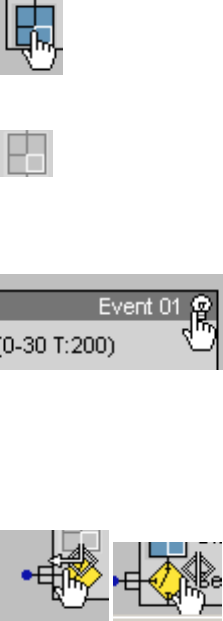
input, which sticks out from the top, or vice-versa. Similarly, you can wire
a global event to a birth event by dragging between the source output on
the bottom of the global event and the event input. The mouse cursor
changes to the first depicted image when you can begin this operation,
and to the second image when you can complete it.
■To pan or zoom the event display, use the controls available from the
Display menu on page 2738 , the right-click menu on page 2745 , or as icons
at the bottom-right of the dialog.
Modifying Actions and Events in the Event Display
■To change the color used by a Display operator, click its color swatch to
the right of its name.
■ To toggle an operator (that is, turn it off and on), click its icon in
the event. The mouse cursor changes to the depicted image when this
action is possible.
A turned-off operator does not affect the particle system, and appears
as gray in the event list; however, its parameters are still available for
editing.
Toggling an instanced operator doesn't affect its other instances.
■ To toggle an event (that is, turn it off and on),
click the light-bulb icon next to its name in the title bar. Turning off an
event is equivalent to turning off all of its operators and tests, although
you cannot turn the operators and tests back on individually. The event's
items do not affect the particle system, and appear as gray in the event
list. All particles entering a turned-off event are immediately passed on to
the next event, if any.
■ To make a test result always True or False, click
its icon's left or right side, respectively. The mouse cursor changes to the
2742 | Chapter 12 Space Warps and Particle Systems
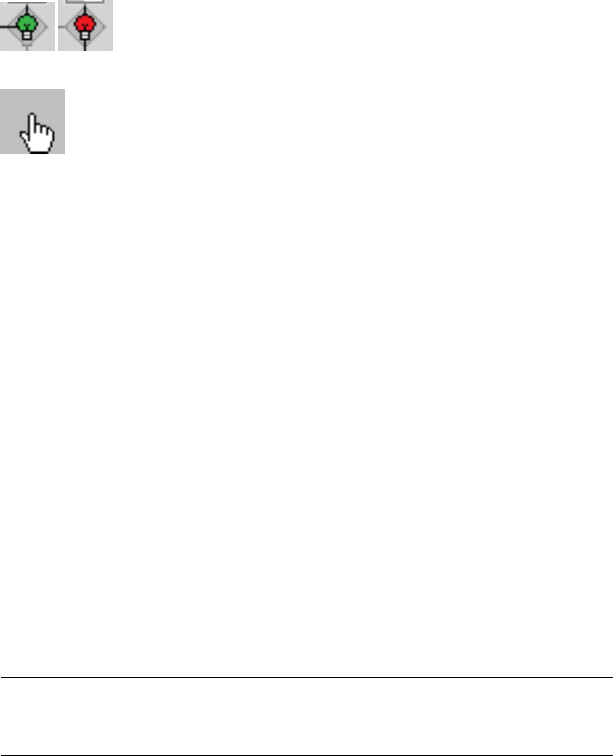
first image at the left (with the left-pointing arrow) when you can click for
always True, and to the second image at the left (without the left-pointing
arrow) when you can click for always False.
The test icon changes to a green or red light bulb to indicate
current functionality: green for always True, and red for always False.
To return to the original functionality, click the icon again. The
mouse cursor changes to the depicted image when this action is possible.
Selecting, Moving, and Copying
■To copy an action or event, first press and hold the Shift key and position
the mouse cursor over the item to copy. When the plus sign (+) appears
next to the mouse cursor arrow, drag the item to a new location. When
you release the mouse button, the Clone Options dialog appears; choose
Copy or Instance and click OK. In the Clone Options dialog, the Event
And Particle System group is unavailable, as a reminder that you cannot
instance these elements. Reference is not an option when cloning Particle
System elements. Cloning an event or particle system simply creates a new
event or particle system containing clones of the original's actions.
Any instanced actions have identical properties. Changing one instance's
values changes them all. On the other hand, copied actions can have
different values.
To clone multiple items, highlight them all before Shift+dragging. If you
attempt to clone a combination of actions and events, or actions from
different events, the result depends on where you start dragging from. If
you drag a highlighted action, you'll clone only actions from that event.
If you drag an event, only highlighted events are cloned.
NOTE When you highlight an instanced action, Particle View indicates all of
its other instances by changing their background color to a lighter shade of
gray.
■To move an event, drag its title bar, or the icon of any of its actions. If you
drag the event to an edge of the display, and scrolling is possible, the
display window will automatically scroll in that direction.
■To resize an event, drag its right edge.
Particle Flow | 2743
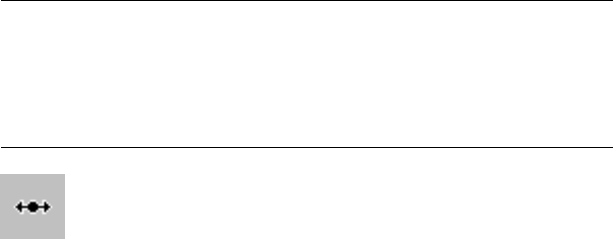
■To highlight multiple items, drag a rectangle around them, or Ctrl+click
them individually.
■To delete an event, action, or wire, highlight it and then press Delete. Be
sure the Particle Dialog is active, or you might inadvertently delete a
selection in the scene instead.
■To move an action, drag its name (not its icon) to the new location. If you
drag the event to an edge of the display, and scrolling is possible, the
display window will automatically scroll in that direction.
If you drag an action to an event, you can insert the action or replace an
existing action, depending on where you position the mouse cursor before
releasing the button. A blue line (before releasing) indicates that it will be
inserted at that location, and a red line indicates that it will replace the
underlying action. If you drag the action to an empty space in the event
display, it will form a new event, and, by default, the system will add a
new Display operator.
NOTE Particle Flow doesn't let you perform illegal operations. For instance, a
Birth operator must always be the first item in a birth event on page 7728 ; the
system doesn't let you position it elsewhere. You can place a Birth operator in
an isolated event, but you can't then wire that event into a particle system,
except in parallel with another birth event. For more information, see the Birth
operator topic on page 2764 .
■ To move a test output or switch it to the opposite side of the event,
drag from just inside the test output to the desired new location. The mouse
cursor changes to the depicted image when this operation is possible.
Getting Information
■To see a renamed action's original type, position the mouse cursor over its
event list entry until the tooltip appears.
■To see a brief description of an action, click it in the depot. The description
appears on the Description panel, to the right of the depot.
2744 | Chapter 12 Space Warps and Particle Systems
Event Display Right-Click Menu
Select a Particle Flow source icon. > Modify panel > Setup rollout > Click
Particle View (or press 6). > Right-click in event display.
Create panel > Geometry > Particle Systems > Object Type rollout > Click PF
Source. > Setup rollout > Click Particle View (or press 6). > Right-click in event
display.
The event display right-click menu provides handy access to a number of
contextual commands. The contents of the menu, as well as the results of its
commands, depend in some cases on where you click, in other cases on what's
highlighted, and in still other cases, on both.
In the following descriptions, “item” means an action or event, or, in some
cases, a wire.
Interface
Insert Displays a submenu of all actions, and when you choose a new action,
inserts it where you originally right-clicked. Available only when you right-click
over an event or action.
If you right-click over an action, and then insert an action, the inserted action
replaces the old one. If you right-click above or below an action (no tooltip
appears), the new action is added to the event at that location. If you right-click
over an event, the action is inserted at the first available position.
Append Displays a submenu of all actions, and when you choose a new
action, inserts it at the end of the event. Available only when you right-click
over an event or action.
Turn On Turns on the event or action under the mouse cursor. Available
only when the item under the mouse cursor is turned on.
To affect an event, the mouse cursor must be over its title bar.
Turning on a highlighted item affects all highlighted items.
Turn Off Turns off the event or action under the mouse cursor. Available
only when the item under the mouse cursor is turned off.
To affect an event, the mouse cursor must be over its title bar.
Turning off a highlighted item affects all highlighted items.
Make Unique Converts an instanced action to a copy that's unique to its
event. Available only when the mouse cursor is over an instanced action.
Particle Flow | 2745
If you right-click over a highlighted, instanced action, Make Unique affects
all such actions.
Wire Wires one or more highlighted tests to a highlighted event, or one or
more highlighted global events to a highlighted birth event. Available only
when one or more tests and a single event are highlighted, or when one or
more global events and a single birth event are highlighted, and when you
right-click over an eligible, highlighted item.
Copy Copies any highlighted events, actions, and wires to the paste buffer.
Available only when the mouse cursor is over an highlighted action, but affects
all highlighted items.
Paste Pastes the contents of the paste buffer to the event display at the mouse
cursor.
If the cursor is over a list, and you copied actions, the actions are added to
the event. If the cursor is over an empty area of the event display, the software
creates a new event containing the pasted actions. A copied event can be
pasted only in an empty area of the event display.
The result of copying and then pasting multiple items depend on what you
copied and the position of the mouse cursor:
■If you copied multiple actions, pasting adds them all to the event under
the mouse cursor, or, if the cursor is over an empty area, to a new event,
even if they originally came from different events.
■Copying multiple events and/or wires pastes them exactly as copied, but
in this case Paste is available only when the mouse cursor is over an empty
area.
■If you copied a combination of actions and events, you can paste them
only when the mouse cursor is over an empty area. Pasting creates a new
event for each group of actions from a single event. For example, if you
highlight event A, some actions from event B, and some actions from event
C, copying and then pasting would add three events: a copy of event A, a
second event with the actions from event B, and a third event with the
actions from event C.
Paste Instanced Pastes the contents of the paste buffer to the event display,
making instances of any pasted actions and their originals.
For the results of pasting multiple copied items, and the limitations based on
mouse position, see Paste, above.
2746 | Chapter 12 Space Warps and Particle Systems

New Add a new item to the event display from the submenu. The submenu
contents are identical to that of the depot. Available only when the mouse
cursor is over an empty area.
Delete Deletes the item under the mouse cursor. Available only when the
mouse cursor is over an item.
If the mouse cursor is over a highlighted item, choosing Delete deletes all
highlighted items.
Rename Lets you rename the item under the mouse cursor. Enter a new
name from the keyboard.
Properties Opens the Object Properties dialog for the event under the mouse
cursor. Available only when the mouse cursor is over the title bar of a
highlighted event.
Particle Flow lets you set object properties on a per-event basis. This lets you
set attributes such as Hide, Renderable, and Motion Blur separately for each
event. Alternatively, you can set properties for the entire particle system from
the global event.
For more information, see Object Properties on page 245 .
NOTE Set properties for events and the particle system only within Particle View
, not via the source icon in the viewports (using the right-click menu > Properties
or Edit menu > Object Properties).
Use Script Wiring Lets you use a script to specify certain parameters in the
Force operator on page 2867 and Keep Apart operator on page 2815 . This
command appears only when you right-click either of the specified, highlighted
operators in an event.
Comments Lets you add comments to each action and event, and view
existing comments. Available only when the mouse cursor is over an action
or the title bar of an event.
Choosing Comments opens a window for entering text from the keyboard.
Begin typing, and click OK to finish. A commented event or action has a red
triangle near its name to indicate the presence of the comment. You can click
this triangle to open the comment.
Particle Flow | 2747
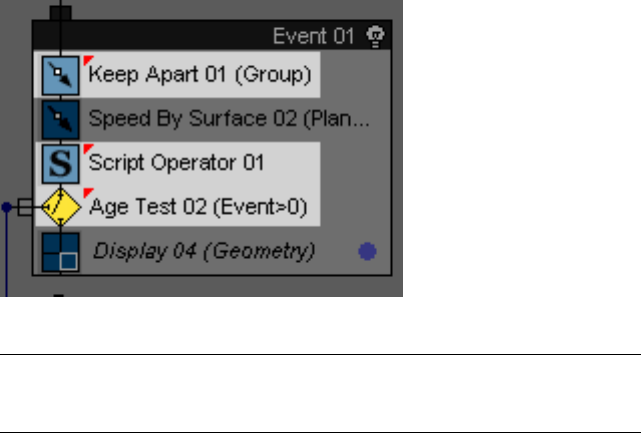
Commented actions; click the triangle to view a comment.
NOTE A comment is specific to the action or event to which it's applied. If you
copy a commented event or action, the comment is not included in the copy,
because it's probably not applicable to the copy.
Pan Switches to the Pan tool. Drag in the event display to change the view;
right-click to exit. Available only when you click over an empty area of the
event display.
Zoom Switches to the Zoom tool. Drag upward in the event display to zoom
in, and downward to zoom out; right-click to exit. Available only when you
click over an empty area of the event display.
Zoom Region Switches to the Zoom Region tool. Drag a rectangle in the
event display to specify the area to zoom into; right-click to exit. Available
only when you click over an empty area of the event display.
Particle Flow Source
Add a Particle Flow system to the scene. > Create panel
Select a PF Source icon. > Modify panel
Particle View on page 2730 > Click a global event (title bar). > Parameters panel
2748 | Chapter 12 Space Warps and Particle Systems
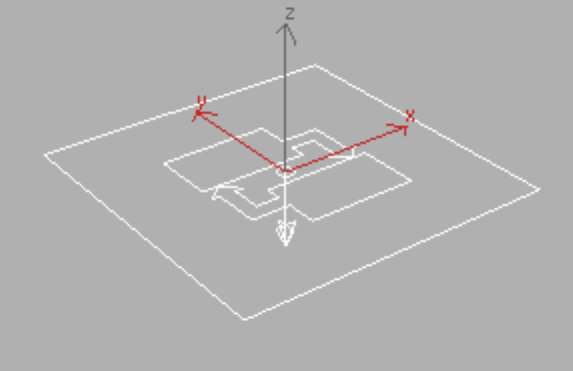
The Particle Flow source is the viewport icon for each flow on page 7787 , and
also serves as the default emitter. By default, it appears as a rectangle with a
central logo (see above illustration), but you can change its shape and
appearance using the controls described below.
When you select a source icon in the viewport, the Particle Flow emitter-level
rollouts appear on the Modify panel. Alternatively, click the title bar of a global
event in Particle View to highlight it, and to access the emitter-level rollouts
from the parameters panel on the right side of the Particle View dialog. Use
these controls for setting global attributes, such as icon properties and the
maximum amount of particles in the flow.
The particle source icon is roughly equivalent to the corresponding global
event on page 7801 in Particle View. They have the same name, but selecting
one does not select the other. If you delete a particle source icon from the
scene, the software converts the global event to an isolated local event in
Particle View, retaining its operators with their settings intact. Any other
events in the system remain in Particle View, along with their wiring. However,
if you delete a global event, the software also removes any local events used
exclusively by that system, as well as the corresponding particle source icon.
To retain the local events, first delete the wire from the global event, and then
delete the global event.
If you clone a particle source in a viewport with Shift+transform or Edit menu
> Clone, an equal number of copies of the global event appear in Particle View,
each wired to the original birth event on page 7728 . The Clone Options dialog
offers only the Copy option. However, if you clone a global event in Particle
View, the Clone Options dialog also lets you create instances of the cloned
Particle Flow | 2749
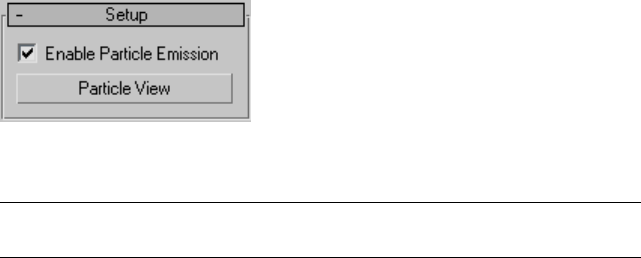
operators and tests. It's not possible to create instances of global and local
events, so these options are unavailable in the Clone Options dialog, as a
reminder. Also, global events cloned in Particle View are not automatically
wired to the original birth event.
Interface
Modifier stack
In the modifier stack, expanding the hierarchy of a Particle Flow source object
provides access to two sub-object levels: Particle and Event. For further
information, see Selection rollout on page 2753 .
Setup rollout
Use these controls to turn the particle system on and off, and to open Particle
View.
NOTE This rollout appears only on the Create and Modify panels, not on the
Particle View dialog > parameters panel.
Enable Particle Emission Turns the particle system on and off. Default=on.
You can also turn off all particle flows in Particle View with Edit menu > Turn
Off All, or a specific particle flow by right-clicking its global event's title bar
and choosing Turn Off.
Particle View Click to open the Particle View dialog on page 2730 .
2750 | Chapter 12 Space Warps and Particle Systems
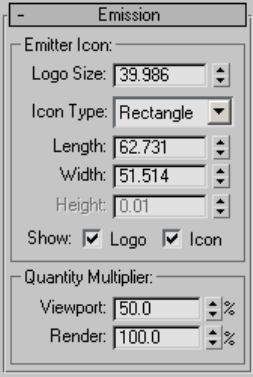
Emission rollout
Sets the physical characteristics of the emitter (particle source) icon, and the
percentage of particles produced in the viewports and when rendering.
Emitter Icon group
Logo Size Sets the size of the Particle Flow logo, which appears at the center
of the source icon, as well as the arrow that indicates the default direction of
particle motion.
By default, the logo size is proportional to that of the source icon; with this
control, you can make it larger or smaller.
This setting affects only the viewport display of the logo; changing it has no
effect on the particle system.
Icon Type Choose the basic geometry of the source icon: Rectangle, Box,
Circle, or Sphere. Default=Rectangle.
This choice matters only if you use the source icon as the particle emitter. The
available size settings depend on which icon type you choose, and, again, are
important only if you use the source icon as an emitter.
The default icon type is Rectangle. If you add a particle system, and then
change the icon type to Box, the icon continues to resemble a rectangle. To
make it look like a box, increase the Height setting.
Particle Flow | 2751
Length/Diameter Sets the length of the Rectangle and Box icon types, and
the diameter of the Circle and Sphere icon types.
Width Sets the width of the Rectangle and Box icon types. Unavailable with
the Circle and Sphere icon types.
Height Sets the height of the Box icon type. Available only with the Box
icon type.
Show Logo/Icon Turns display of the logo (with arrow) and icon on and off,
respectively.
These settings affect only the viewport display of these items; they have no
effect on the particle system.
Quantity Multiplier group
These settings determine the percentage of the total number of particles in
each flow on page 7787 that are actually produced in the viewports and at
render time. They don't affect the percentage of particles that are visible; those
are determined by the Display operator on page 2864 and Render operator on
page 2872 . You can use them to quickly decrease or increase the number of
particles consistently throughout all events in the particle system. The
maximum setting, 10,000%, lets you multiply the number of particles
generated by the flow by 100.
The total number of particles is determined by the combined effects of the
following operators and tests: Birth on page 2764 , Birth Script on page 2767 ,
Delete on page 2768 , Collision Spawn on page 2885 , and Spawn on page 2912 .
Scripted operators and tests can also affect this number.
Viewport Sets the percentage of the total number of particles in the system
produced in the viewports. Default=50.0. Range=0.0 to 10000.0.
Render Sets the percentage of the total number of particles in the system
produced at render time. Default=100.0. Range=0.0 to 10000.0.
2752 | Chapter 12 Space Warps and Particle Systems
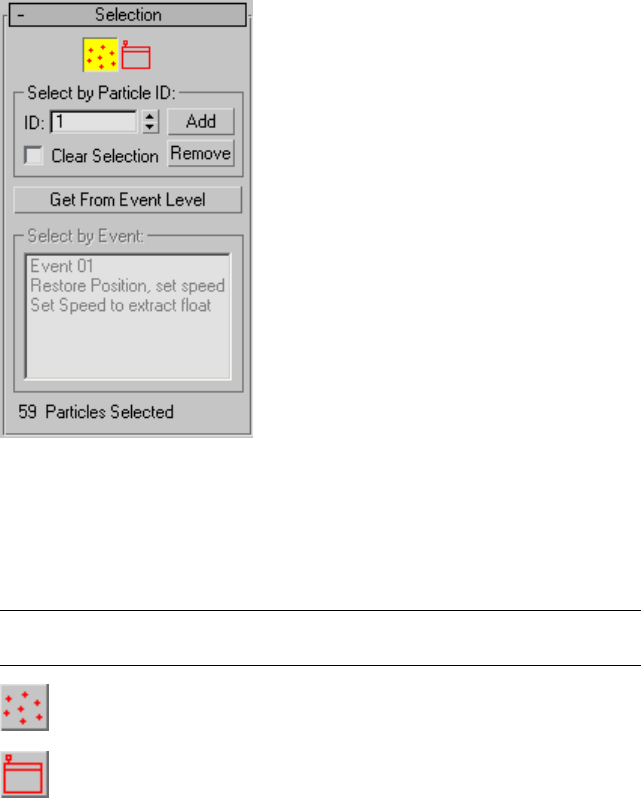
Selection rollout
Use these controls for selecting particles on a per-particle or event basis.
Selection of particles at the Event level is for debugging and tracking purposes.
Particles selected at the Particle level can be acted upon by the Delete operator
on page 2768 and the Split Selected test on page 2921 . You cannot directly
manipulate selected particles with standard 3ds Max tools such as Move and
Rotate.
NOTE This rollout appears only on the Modify panel, not on the Create panel or
Particle View dialog > parameters panel.
Particle Lets you select particles by clicking them or dragging a region.
Event Lets you select particles by event. At this level, you can select
all particles in one or more events by highlighting the event(s) in the Select
By Event list on page 2754 , or in the viewports with standard selection methods.
To convert a selection from the Event level to the Particle level for use with
the Delete operator or Split Selected test, use Get From Event Level on page
2754 .
Particle Flow | 2753
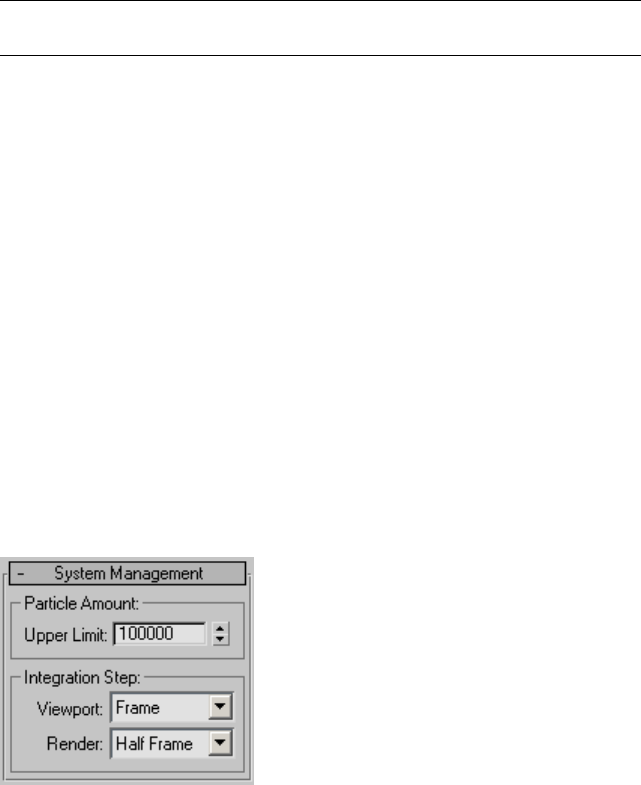
Selected particles appear in the viewports in red (if not geometry), in the form
designated by the Display operator > Selected setting on page 2867 .
Select by Particle ID group
Each particle has a unique ID number, starting with 1 for the first particle and
counting up. Use these controls to select and deselect particles by their ID
numbers. Available only at the Particle selection level.
TIP You can display particle IDs in the viewports by turning on Display operator
> Show Particle IDs.
ID Use this to set the ID number of the particle you want to select. You can
set only one number at a time.
Add After setting the ID number of a particle to select, click Add to add it
to the selection. By default, selecting a particle doesn't deselect any others.
Remove After setting the ID number of a particle to deselect, click Remove
to remove it from the selection.
Clear Selection When on, clicking Add to select a particle deselects all other
particles.
Get From Event Level Click to convert an Event-level selection to the Particle
level. Available only at the Particle level.
Select By Event This list shows all events in Particle Flow, and highlights
selected events. To select all of an event's particles, click its list entry, or use
standard viewport-selection methods.
# Particles Selected Shows the number of selected particles.
System Management rollout
2754 | Chapter 12 Space Warps and Particle Systems

Use these settings to limit the number of particles in the system, and to specify
the frequency of updating the system.
Particle Amount group
Upper Limit The maximum number of particles the system may have.
Default=100000. Range=1 to 10000000.
TIP You can have more than 10,000,000 particles in a single system by using
multiple particle sources and wiring them to the same birth event. Note, however,
that Particle Flow is limited to sending a maximum of 5,000,000 particles per
event to the renderer.
Integration Step group
At each integration step, Particle Flow updates the particle system, applying
each active action to particles in its event. A smaller integration step can
improve accuracy, at the cost of calculation time. These settings let you apply
different integration steps to the particle animation in the viewports and at
render time.
In most cases, the default Integration Step settings work fine. One instance
in which increasing the integration-step frequency might help is when
fast-moving particles that should collide with a deflector penetrate it instead.
Viewport Set the integration step for animation playback in the viewports.
Default=Frame (once per animation frame). Range=1/8 Frame to Frame.
Render Set the integration step at render time. Default=Half Frame (twice
per animation frame). Range=1 Tick to Frame.
There are 4,800 ticks in a second; thus, at the NTSC video rate of 30 frames
per second, there are 160 ticks per frame.
Particle Flow | 2755
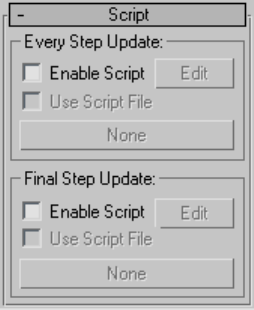
Script rollout
This rollout lets you apply a script to the particle system at each integration
step, as well as after the last integration step of each frame you view. Use an
Every Step Update script to set up history-dependent properties, and a Final
Step Update script to set up history-independent properties.
Every Step Update group
The Every Step Update script is evaluated at the end of each integration step,
after all actions in the particle system are evaluated, and all particles are finally
in their respective events. When, for example, you are setting up Material ID
according to a particle index, it is important to be sure that particles are not
about to jump to another event.
When you set up history-dependent properties, such as speed, it is important
to do that at every integration step, because otherwise the final position would
be quite different.
Enable Script Turn on to cause a script in memory to be executed at each
integration step. You can modify this script by clicking the Edit button, or
load and use a script file with the remaining controls in this group.
The default script modifies particle speed and direction, causing particles to
follow a wavy path.
Edit Click this button to open a text-editor window with the current script.
When Use Script File is off, this is the default Every Step Update script
(3dsmax\scripts\particleflow\example-everystepupdate.ms). When Use Script File
is on, this is the loaded script, if you've loaded one. If you haven't, clicking
Edit displays the Open dialog.
2756 | Chapter 12 Space Warps and Particle Systems
Use Script File When on, you can load a script file by clicking the button
below.
[button] Click this button to display an Open dialog that lets you specify a
script file to load from disk. After you load a script, the name of script file
appears on the button.
Final Step Update group
The Final Step Update script is executed after the last integration step has been
completed for each frame that you view (or render). For example, if you play
the animation in the viewport with Real Time turned off, Particle Flow runs
this script at each frame, immediately before the particle system is rendered
to the viewport. However, if you simply jump to a different frame, the script
is run once only, so if the script assumes a certain history, you might get
unexpected results.
For this reason, it's best to use the Final Step Update script to modify
history-independent properties. For example, if no operators in the system
depend on the material indices, you could use it to modify the material index.
In this case there's no need to set those indices in every intermediate
integration step. Also, you can set up a position channel in the Final Step
Update script if you know the analytical expression for the position.
Enable Script Turn on to cause a script in memory to be executed after the
final integration step. You can modify this script by clicking the Edit button,
or load and use a script file with the remaining controls in this group.
The default script modifies particle speed and direction, causing particles to
follow a bulb-shaped path.
Edit Click this button to open a text-editor window with the current script.
When Use Script File is off, this is the default Final Step Update script
(3dsmax\scripts\particleflow\example-finalstepupdate.ms). When Use Script File is
on, this is the loaded script, if you've loaded one. If you haven't, clicking Edit
displays the Open dialog.
Use Script File When on, you can load a script file by clicking the button
below.
[button] Click this button to display an Open dialog that lets you specify a
script file to load from disk. After you load a script, the name of script file
appears on the button.
Particle Flow | 2757
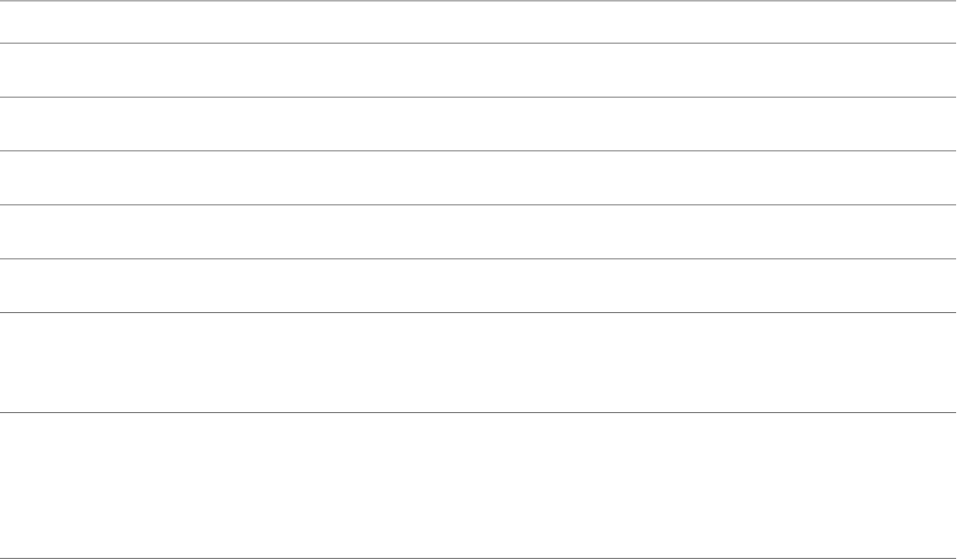
Particle Flow Keyboard Shortcuts
To use Particle Flow keyboard shortcuts, the Keyboard Shortcut Override Toggle
on the main toolbar must be turned on.
To view and customize these shortcuts, open the Customize User Interface
dialog from the Customize menu, and then, from the Group drop-down menu,
choose Particle Flow.
DescriptionKeyboard ShortcutParticle Flow Function
Ctrl+CCopy Selected In Particle View*
Toggles active status of all particle systems.;Particle Emission Toggle
Toggles Particle View dialog.6Particle View Toggle
Ctrl+VPaste In Particle View*
Selects all events, actions, and wires.Ctrl+ASelect All In Particle View*
Toggles active status only of particle sys-
tems whose icons are selected in the
viewports.
Shift+;Selected Particle Emission Toggle
* These functions are specific to Particle
View. It is recommended that you use
Customize User Interface to change their
keyboard shortcuts only, and not assign
them to toolbars, quads, or menus.
Actions
The Particle Flow components for creating particle systems are known
collectively as actions. These are subdivided into three main categories:
■Operators on page 2761
■Flows on page 2875
2758 | Chapter 12 Space Warps and Particle Systems
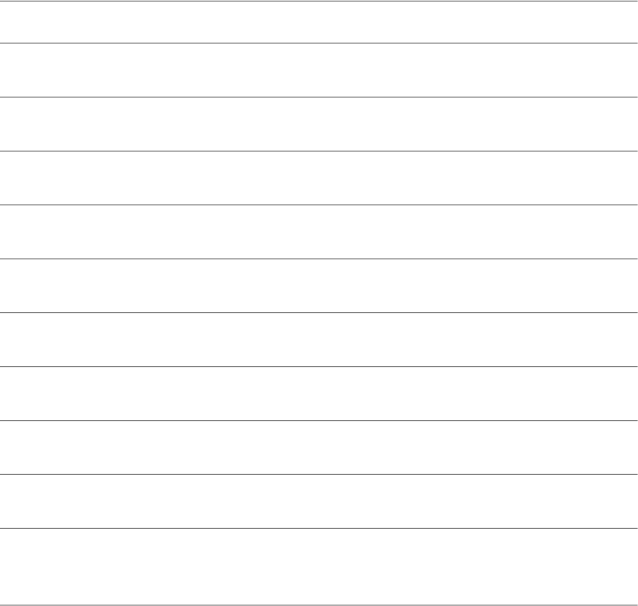
■Tests on page 2877
Action Time Frames
Most actions in Particle Flow operate on particles in either of two time frames:
once, when the particle first enters the event, or on a continuous basis,
potentially changing particle behavior at each integration step. Some actions
can work only in one time frame, while others can work on an instantaneous
or continuous basis, depending on their settings. The tables below list each
action with its time frame.
Operators
Time FrameOperator
n/aBirth
n/aBirth Script
n/aDelete
ContinuousForce
ContinuousKeep Apart
ContinuousMapping
ContinuousMaterial Dynamic
OnceMaterial Frequency
OnceMaterial Static
Once, except continuous with Lock On
Emitter
Position Icon
Particle Flow | 2759
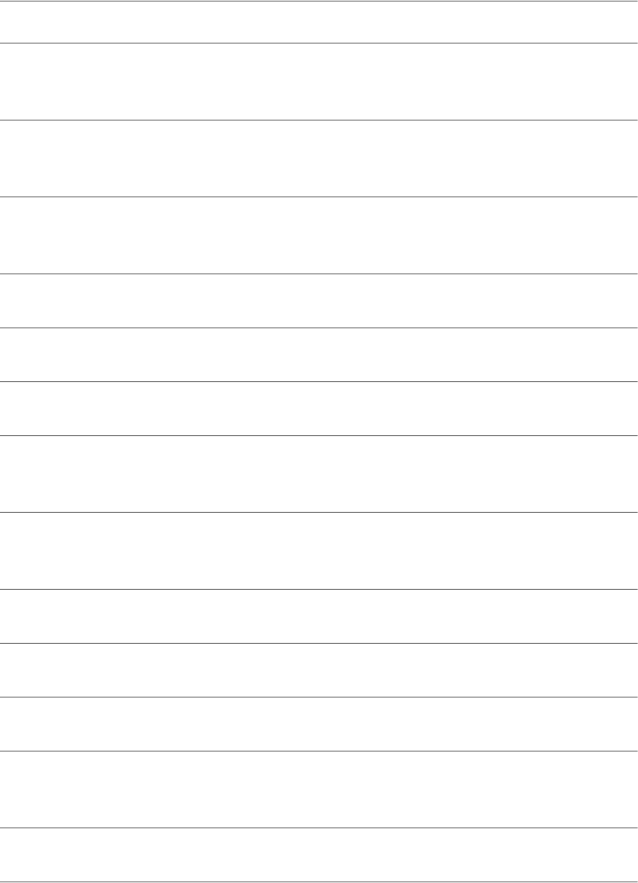
Time FrameOperator
Once, except continuous with Lock On
Emitter
Position Object
Once, except continuous with Speed Space
Follow
Rotation
Once, except continuous with Absolute
and Relative options
Scale
Depends on scriptScript Operator
OnceShape
ContinuousShape Facing
Once, except continuous with Animated
Shape
Shape Instance
Once, except continuous with Align To
Surface Animation
Shape Mark
OnceSpeed
ContinuousSpeed By Icon
Depends on settingSpeed By Surface
Once, except continuous with Speed Space
Follow
Spin
n/a=not applicable
Tests
Most tests in Particle Flow function only as tests. At each integration step,
they check each particle for the specified conditions, and then return the test
2760 | Chapter 12 Space Warps and Particle Systems
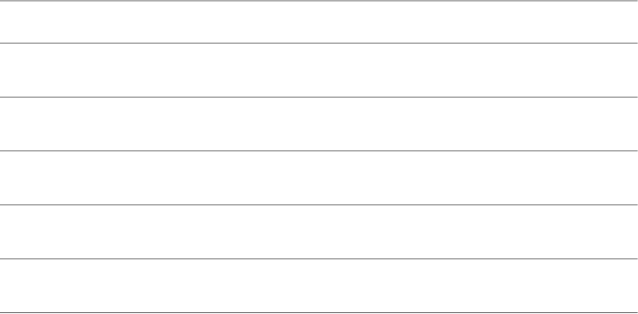
result: True or False. So, as tests, they work on a continuous basis. For example,
Age Test checks each particle's age at every integration step, because particles
might not reach the specified age until remaining in the event for a while,
and also because another action in the event might change or reset particle
age.
The principal exceptions to this are the Split tests, which test each particle
only when it first enters the event. That is, a Split test splits the particle stream
only once for each particle that enters the event. Any particles that remain in
the event are not subject again to being split off from the stream by the same
test. Also, the Send Out test performs no test, but simply moves particles along
to the next event.
Some tests also function as operators, in that they directly affect particle
behavior. These are the ones listed here, and the specified time frame is related
to the operator functionality, not the test.
Time FrameTest
ContinuousCollision Spawn
ContinuousFind Target
ContinuousGo To Rotation
Depends on scriptScript Test
Continuous, except once with OnceSpawn
Operators
The operator is the basic element of the particle system; you combine operators
into events to specify the particles' characteristics over a given period of time.
Operators let you describe particle speed and direction, shape, appearance,
and more.
The operators reside in two groups in the Particle View depot, and within each
group appear in alphabetical order. Each operator's icon has a blue background,
except for the Birth operators, which have a green background. The first group
contains operators that directly affect particle behavior, such as transformation.
Particle Flow | 2761
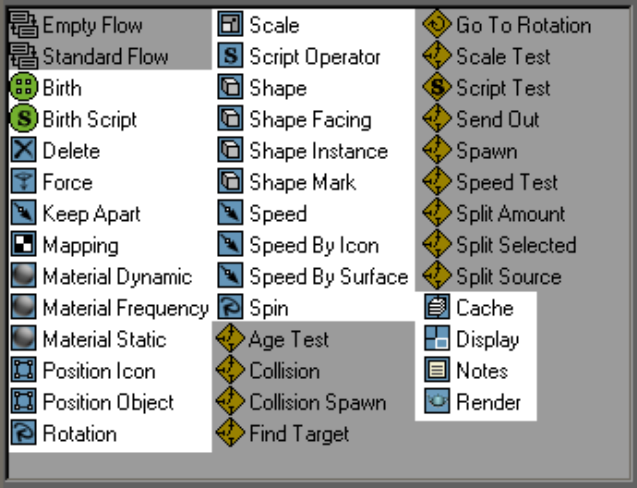
The second group, found at the end of the depot listing, contains four operators
that serve more of a utility function: Cache, for optimizing particle-system
playback; Display, for determining how particles appear in the viewports;
Notes, for adding comments; and Render, for specifying render-time
characteristics.
The Particle Flow operators in the Particle View depot
The primary operators in Particle Flow are:
Birth Operator on page 2764
Birth Script Operator on page 2767
Delete Operator on page 2768
Force Operator on page 2867
Keep Apart Operator on page 2815
Mapping Operator on page 2853
Material Dynamic Operator on page 2846
Material Frequency Operator on page 2844
2762 | Chapter 12 Space Warps and Particle Systems
Material Static Operator on page 2841
Position Icon Operator on page 2770
Position Object Operator on page 2773
Rotation Operator on page 2781
Scale Operator on page 2785
Spin Operator on page 2783
Select and Uniform Scale on page 892
Script Operator on page 2874
Shape Operator on page 2821
Shape Facing Operator on page 2822
Shape Instance Operator on page 2825
Shape Mark Operator on page 2832
Speed Operator on page 2791
Speed By Icon Operator on page 2796
Speed By Surface Operator on page 2806
The utility operators are:
Cache Operator on page 2856
Display Operator on page 2864
Notes Operator on page 2871
Render Operator on page 2872
See also:
■Flows on page 2875
■Tests on page 2877
Particle Flow | 2763

Birth and Death
Birth Operator
Particle View on page 2730 > Click Birth in an event or add a Birth operator to
the particle system and then select it.
The Birth operator enables creation of particles within the Particle Flow system
using a set of simple parameters. In general, use Birth as the first operator in
any event connected directly to a global event on page 7801 ; this is called the
birth event on page 7728 .
You can specify a total number of particles, or a rate of particles born per
second. You can also tell the system when to begin emitting particles, and
when to stop.
NOTE The Birth operator must always come at the beginning of a particle stream;
the system doesn't let you position it elsewhere. You can place a Birth operator in
an isolated event, but you can't then wire that event in series with a stream that
already uses a Birth operator. However, you can wire multiple Birth operators,
each in its own event, into a particle stream with an existing Birth operator, in
parallel . The following procedure illustrates this. If you need to create particles
midstream, use the Spawn Test on page 2912 or Collision Spawn Test on page
2885 test.
See also:
■Birth Script Operator on page 2767
Procedures
To use the Birth operator:
This procedure demonstrates the impossibility of using multiple Birth operators
in series, and shows how to use multiple Birth operators in parallel.
1Start or reset the software, and add a new PF Source object to the scene.
2Press 6 to open Particle View.
The default particle system contains a Birth operator as the first action
in the birth event.
3Try to drag the Birth operator elsewhere in Event 01.
2764 | Chapter 12 Space Warps and Particle Systems
You can't. As you drag over the different actions in Event 01, a red line
appears at the top of the event, showing that the Birth operator will be
placed here, no matter where you release the mouse button.
4Try to drag a new Birth operator from the depot to Event 01.
As in the previous step, the only place you can drop the Birth operator
is at the top of the event, replacing the existing Birth operator.
5From the depot, drag the Birth operator to an empty area in the event
display.
Particle Flow creates a new birth event, Event 02, containing the Birth
operator and a Display operator.
6Wire the output of the global event, PF Source 01, to the event input of
Event 02.
Each birth event must be associated with a global event to be able to
generate particles.
7From the depot, add a Send Out test at the end of both Event 01 and
Event 02.
8Try to wire the test output of Event 02 to the event input of Event 01.
Particle Flow doesn't let you, because this would result in two Birth
operators in series.
9Try to wire the test output of Event 01 to the event input of Event 02.
Again, Particle Flow doesn't let you, because this would result in two Birth
operators in series.
10 Drag a Speed operator to an empty area of the event display.
Particle Flow creates a new event, Event 03.
11 Wire the test output of Event 01 to the event input of Event 03.
12 Wire the test output of Event 02 to the event input of Event 03.
There's no problem wiring the two birth events to a single, third event.
The birth events exist in the particle stream in parallel, each generating
particles independently and then feeding its particle stream into a
common event, where the two streams are combined.
If the second birth event had its own global event, you could, at any
point further downstream, separate the streams back out according to
their origin using the Split Source test on page 2922 . To do this, delete the
wire from PF Source 01 to Event 02, add an Empty Flow on page 2875 to
the system, and then wire it to Event 02.
Particle Flow | 2765
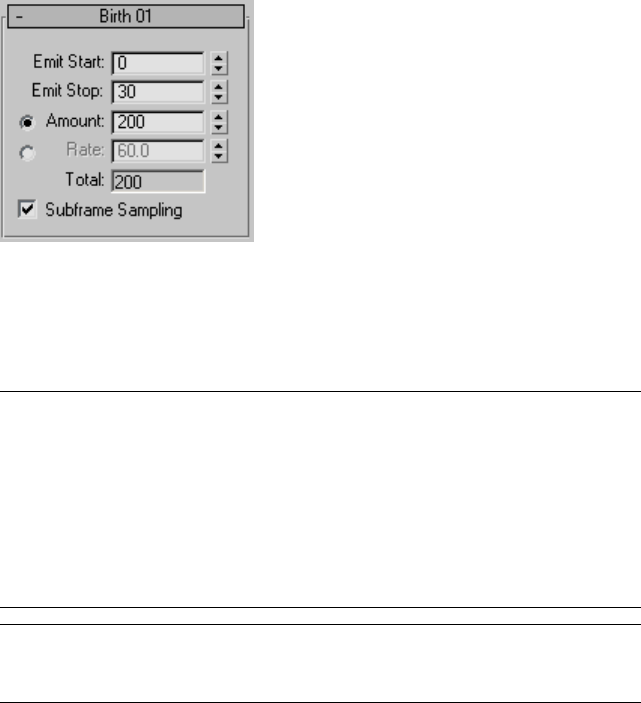
Interface
The user interface appears in the parameters panel, on the right side of the
Particle View dialog.
Emit Start The frame number at which the operator begins emitting particles.
Emit Stop The frame number at which the operator stops emitting particles.
NOTE The Emit Start and Emit Stop values are tied to the system frame rate. If
you change the frame rate, Particle Flow automatically adjusts the Emit values
accordingly. For example, if you set Emit Start to 120 and Emit Stop to 300 using
the default NTSC frame rate (30 fps), and then switch to PAL (25 fps) using the
Time Configuration dialog, you've reduced the frame rate to 5/6 of the original
value. Thus, Particle Flow automatically uses the same ratio to adjust the Emit
settings, resulting in an Emit Start value of 100 and an Emit Stop value of 250.
This allows the particle system to retain the timing you specify, no matter which
frame rate you use.
NOTE With Subframe Sampling off, such adjustments are rounded off to the
nearest integer frame number. With Subframe Sampling on, fractional frame values
that result from such adjustments will be used, but not displayed.
Amount To specify the total number of particles emitted by the operator,
choose Amount, and then set the quantity of particles.
Using the Amount option, the first particle is always emitted at the Emit Start
frame, and the last particle is always emitted at the Emit Stop frame. Particles
emitted between these endpoints appear at equal intervals within the emission
period. For example, if you set Amount to 3, the second particle is emitted
halfway through the emission period.
2766 | Chapter 12 Space Warps and Particle Systems

To determine the number of particles emitted per frame when using Amount,
divide the Amount value by the number of emission frames (Emit Stop-Emit
Start+1).
Rate To specify the number of particles emitted per second, choose Rate, and
then set the value. The operator emits this number of particles per second
starting at the Emit Start frame and ending at the Emit Stop frame.
If you specify a birth rate value that isn’t an integer multiple of the system
frames-per-second value (set in the Time Configuration dialog), Particle Flow
uses interpolation to determine when to emit particles. For example, if you
use the system default rate of 30 frames per second, and set the birth rate to
4, the system would emit each particle at intervals of seven or eight frames if
Subframe Sampling is off, or at intervals of 7.5 frames if Subframe Sampling
is on.
Total The calculated total number of particles emitted by the operator.
Subframe Sampling Turning this on helps avoid particle "puffing" by emitting
particles at a much higher subframe resolution (that is, throughout each
frame), rather than using the relatively coarse frame resolution. Default=on.
"Puffing" is the effect of emitting separate "puffs" or clusters of particles, rather
than a continuous stream. This effect is especially noticeable when the emitter
is animated.
Turn off Subframe Sampling to cause particles to be emitted exactly at frame
times. This makes it easier to sort particles by their age later.
TIP If, when using the Collision on page 2881 or Collision Spawn test on page 2885
, you experience an irregular particle stream, try turning off Subframe Sampling.
Birth Script Operator
Particle View on page 2730 > Click Birth Script in an event or add a Birth Script
operator to the particle system and then select it.
The Birth Script operator enables creation of particles within the Particle Flow
system using a MAXScript script. The script can use any program functionality
available to MAXScript.
The default script (3dsmax\scripts\particleflow\example-scriptbirth.ms) emits
particles for 100 frames in a wavy, circular path. To see this, turn off or delete
any Speed and Position operators in the event.
Particle Flow | 2767
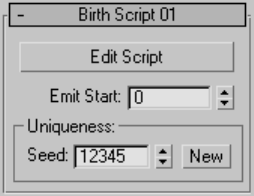
See also:
■Birth Operator on page 2764
Interface
The user interface appears in the parameters panel, on the right side of the
Particle View dialog.
Edit Script Click this button to open the current script in a MAXScript Editor
window.
For detailed information about the MAXScript utility, open the MAXScript
Reference, available from Help menu > MAXScript Reference.
Emit Start The frame number at which the operator begins emitting particles.
Uniqueness group
The Uniqueness setting provides a randomization seed that the script can use
or ignore.
Seed Specifies a randomization value.
New Calculates a new seed using a randomization formula.
Delete Operator
Particle View on page 2730 > Click Delete in an event or add a Delete operator
to the particle system and then select it.
Use the Delete operator to remove particles from the particle system. By default,
particles live “forever,” that is, for the duration of the animation. The Delete
operator lets you give them a finite life span. This is useful for eliminating
particles once they've served their purpose in the animation.
2768 | Chapter 12 Space Warps and Particle Systems
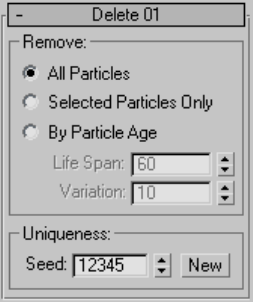
The Delete operator is also necessary when using the Particle Age map, which,
when incorporated into the Material Dynamic operator, applies different
materials to particles depending on their age. Because the map works on the
basis of a percentage of the particle's life span, you need to use a Delete operator
to define the particles' maximum age. For an example of usage, see Material
Dynamic operator on page 2846 .
Interface
The user interface appears in the Parameters panel, on the right side of the
Particle View dialog.
Remove group
Choose whether to delete all particles, selected particles, or particles past a
specific age.
The Uniqueness setting enables randomization of maximum particle age using
the By Particle Age > Variation setting.
All Particles Deletes all particles in the event immediately.
Selected Particles Only Deletes particles selected at the Particle sub-object
level in the event immediately. See Selection rollout on page 2753 .
By Particle Age Deletes particles in the event after they've existed for a specific
length of time, with an optional random variation. Choosing this makes the
Life Span and Variation settings available.
Life Span The number of frames of life allowed to the particles. After this
period, they're deleted. Default=60.
Particle Flow | 2769
Variation The maximum amount by which Life Span may vary. To get each
particle's actual life span, this value is multiplied by a random number between
-1.0 and 1.0, and then added to Life Span. Default=10.
Uniqueness group
The Uniqueness setting enables randomization of maximum particle age using
the By Particle Age > Variation setting.
Seed Specifies a randomization value.
New Calculates a new seed using a randomization formula.
Transforms
Position Icon Operator
Particle View on page 2730 > Click Position in an event or add a Position
operator to the particle system and then select it.
By default, particles are born, or emitted, from the Particle Flow icon. This
topic uses the term emitter to refer to this icon. Use the Position Icon operator
to control the initial placement of particles on the emitter. You can set the
emitter to emit particles from its surface, volume, edges, vertices, or center.
And, if you animate the emitter, you can cause its motion to be imparted to
the particles it emits.
Alternatively, you can use Position Object on page 2773 to emit particles from
any other object.
2770 | Chapter 12 Space Warps and Particle Systems
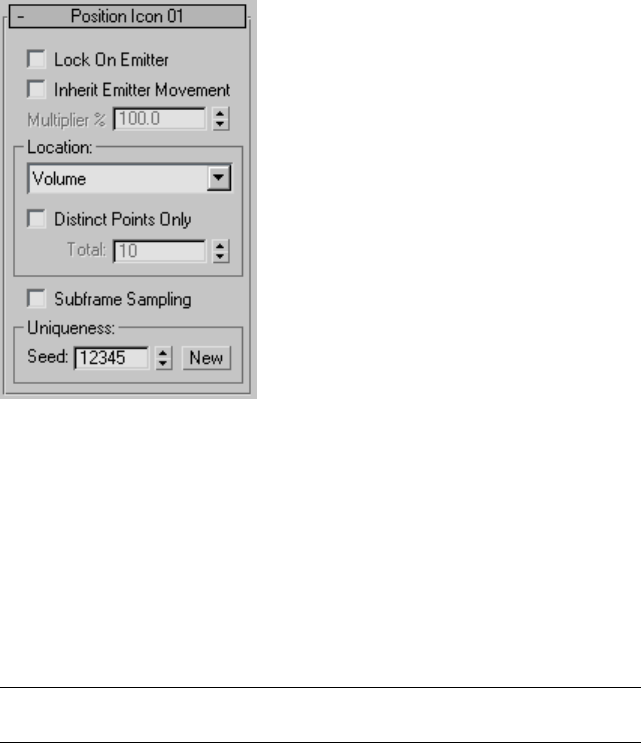
Interface
The user interface appears in the parameters panel, on the right side of the
Particle View dialog.
Lock On Emitter When on, causes all particles to remain at their initial
positions on the emitter. In effect, they're “glued” to the emitter. When off,
each particle's birth position is determined by the emitter's current location.
Default=off.
Inherit Emitter Movement When on, the software sets each particle's rate
and direction of motion to that of the emitter at the time of birth. When off,
the emitter movement doesn't affect that of the particles. Available only when
Lock On Emitter is off. Default=off.
NOTE If a Speed operator exists later in the event, it overrides any motion imparted
by Inherit Emitter Movement.
Multiplier Determines, as a percentage, the extent to which particles inherit
the emitter's motion. Available only when Inherit Emitter Movement is on.
Default=100.
To have the particles move half as fast as the emitter, set Multiplier to 50. To
have them move the same speed, use the default setting of 100. To make the
particles move twice as fast as the emitter, set Multiplier to 200.
Particle Flow | 2771
Location group
The Location drop-down list lets you specify where on the emitter the particles
appear. You can create a variety of emission behaviors by varying the icon
type on page 2751 , Location setting, and direction of emission. Default=Volume.
■Pivot Emits particles from the center of the icon.
■Vertices For the Box and Rectangle icon types, emits particles from the
corners of the icon. For the Sphere icon type, emits particles from the six
intersections of the three circles that define the sphere. For the Circle icon
type, emits particles from the center.
■Edges Emits particles from random points along the edges of the icon.
■Surface Emits particles from random points on the surface of the icon.
■Volume Emits particles from random points within the volume of the
icon.
Distinct Points Only Limits emission to a specific number of points (see Total,
below) on the specified Location type.
Emission points are still randomized; change the Uniqueness setting to alter
these.
Total Sets the number of emission points. Available only when Distinct
Points Only is on. Default=10.
Subframe Sampling When on, the operator acquires animation of the emitter
icon on a tick basis (every 1/4800th of a second) rather than a frame basis.
This provides greater precision in allowing the particle positions to follow
animation of the emitter icon. Default=off.
Uniqueness group
The Uniqueness setting lets you alter the randomization of emission points.
Seed Specifies a randomization value.
New Calculates a new seed using a randomization formula.
2772 | Chapter 12 Space Warps and Particle Systems
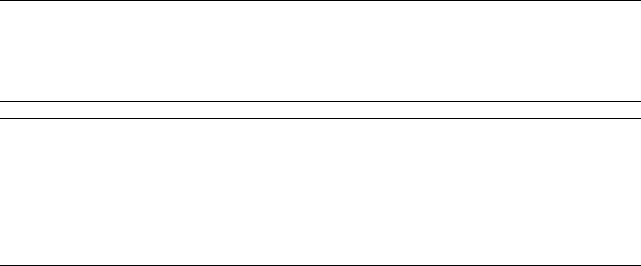
Position Object Operator
Particle View on page 2730 > Click Position Object in an event or add a Position
Object operator to the particle system and then select it.
By default, particles are born, or emitted, from the Particle Flow icon. The
Position Object operator lets you emit particles from any other object or objects
in the scene instead. This topic uses the term emitter to refer to an object or
objects used to emit particles with this operator. For example, use it to create
a meteor's fiery trail.
Use the Position Object settings to control the initial placement of particles
on the emitter. You can set the emitter to emit particles from its surface,
volume, edges, vertices, or pivot, or from a sub-object selection. You can also
control particle emission with a material applied to the object.
Alternatively, you can use the Position Icon operator on page 2770 to emit
particles from the Particle Flow icon.
NOTE Typically, you would use Position Object in a birth event, so the particles
appear initially at the emitter object(s). If you use it in a non-birth event, the
particles jump to the designated emitter(s) upon entering the event. This could
be useful for a teleportation effect.
TIP The default speed operator, Speed on page 2791 , typically uses the Particle
Flow icon to control the direction of the particle flow, so if the emitter object(s)
and the icon aren't coincident and aligned, you might get unexpected results. For
better control over the direction of particle movement when using Position Object,
use the Speed By Surface operator on page 2806 instead and designate as Surface
Geometry the same object(s) as with Position Object.
Procedures
To use Position Object:
1Create a Particle Flow system and one or more mesh objects to use as
emitters. Animate the emitter objects and set particle system parameters
as necessary.
2In Particle View, add a Position Object operator to the birth event,
replacing the Position Icon operator if one exists. Click the operator to
display its parameters.
Particle Flow | 2773
3In the Emitter Objects group, click Add, and then select an object to serve
as the emitter. Alternatively, click By List and then use the Select Emitter
Objects dialog to designate one or more objects as emitters.
4Use the Location drop-down list to choose where the particles should
appear on the emitter: surface, vertices, and so forth.
5Set other options as necessary. For example, if you want the particles to
use the same motion as the emitter at the time of emission, turn on
Inherit Emitter Movement. Or if you're using an emitter object whose
shape is animated, turn on Animated Shape.
2774 | Chapter 12 Space Warps and Particle Systems

Interface
Particle Flow | 2775

The user interface appears in the parameters panel, on the right side of the
Particle View dialog.
Lock On Emitter When on, causes all particles to remain at their initial
positions on the emitter. In effect, they're “glued” to the emitter. When off,
each particle's birth position is determined by the emitter's current location.
Default=off.
Inherit Emitter Movement When on, the software sets each particle's speed
and direction of motion to those of the emitter at the time of birth. When
off, the emitter movement doesn't affect that of the particles. Available only
when Lock On Emitter is off. Default=off.
NOTE If a Speed operator exists later in the event, it overrides any motion imparted
by Inherit Emitter Movement.
Multiplier Determines, as a percentage, the extent to which particles inherit
the emitter's motion. Available only when Inherit Emitter Movement is on.
Default=100.
To have the particles move half as fast as the emitter, set Multiplier to 50. To
have them move the same speed, use the default setting of 100. To make the
particles move twice as fast as the emitter, set Multiplier to 200.
Variation Determines, as a percentage, the extent to which inherited emitter
motion can vary per particle. To determine the final multiplier for each particle,
the Variation value is multiplied by a random number between -1.0 and 1.0,
and then added to the Multiplier value. Default=0.
Emitter Objects group
Use these controls to assign objects to be used as particle emitters. The list in
this group shows the objects, or reference geometry, that the operator uses as
emitters.
If you don't assign any objects, Particle Flow uses the world origin (0,0,0) as
the emitter source.
With more than one emitter object, the division of particles among the objects
depends on which option you choose for Location. If you set Location to
Pivot, then each object has one emission point and each object emits the same
number of particles (total number of particles/number of objects). But if you
set Location to any other option, each object emits a number of particles
proportionate to the number of available emission points per object. For
instance, if you set Location to Volume, then a larger object will emit more
2776 | Chapter 12 Space Warps and Particle Systems
particles than a smaller one. Similarly, with Location set to Vertices, an object
with 100 vertices will emit twice as many particles as an object with 50.
If you delete from the scene an object designated as an emitter, its entry in
the list is replaced with “<deleted>”.
Use the Add and Remove buttons to edit this list.
Add Adds an object to the list. Click Add, and then click an object in the
viewport.
By List Adds multiple objects to the list. Click By List to open the Select
Emitter Objects dialog. This works just like Select From Scene on page 168 :
Highlight the objects to use as emitters, and then click the Select button.
Remove Removes an object from the list. Highlight the object in the list,
and then click Remove.
Animated Shape Turn on to allow particles to emit from the surface of an
object whose form is animated by morphing or with modifiers.
Subframe Sampling When on, the operator acquires animation of the emitter
shape on a tick basis (every 1/4800th of a second) rather than a frame basis.
This provides greater precision in allowing the particle positions to follow
animation of the emitter object's form.
Location group
The Location drop-down list lets you specify where on each emitter the
particles appear. This choice applies to all emitter objects. Default=Surface.
The Selected Vertices/Edges/Faces options in this list let you emit particles
from a specific part of the emitter object by using an existing sub-object
selection. To create this selection, first convert the object to an editable mesh
or poly, or apply a Mesh Select or Poly Select modifier (or equivalent), select
the sub-objects that are to emit particles, and then choose the corresponding
Location option. If the software doesn't find a sub-object selection, it uses all
sub-objects of the indicated type.
Pivot Emits particles from the original position of the emitter object's pivot.
Moving the pivot does not affect this option.
Vertices Emits particles from randomly selected vertices of the emitter objects.
Edges Emits particles from random points along the edge sub-objects of the
emitter objects.
Surface Emits particles from random points on the surface of the icon.
Volume Emits particles from random points within the volume of the icon.
Particle Flow | 2777
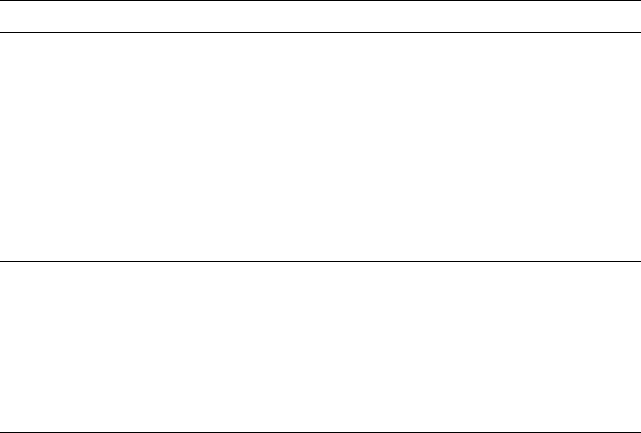
Selected Vertices Emits particles from the current vertex sub-object selection.
Selected Edges Emits particles from the current edge sub-object selection.
Selected Faces Emits particles from the current face or polygon sub-object
selection.
You can modify the Location choice with any combination of the following:
Surface Offset Lets you specify a range of distances from the object surface
for particle placement.
Surface Offset is unavailable when Location is set to Pivot or Volume. Use the
Min and Max parameters to set the range.
NOTE Negative values offset the particles below the surface.
Min/Max When Surface Offset is on, these let you specify the range of offset
distances from the object surface. The Min value cannot exceed the Max value,
and vice-versa. If you try to raise Min above Max, or lower Max below Min,
both values change equally.
Density by Material Varies emission over the emitter surface based on
properties of the material applied to the emitter. For example, if the object is
assigned a black-and-white checkered diffuse map and you choose the
Grayscale option, particles are emitted only from the white checks.
IMPORTANT For material-influenced emission to appear properly in the viewports,
two conditions are required:
■At least one viewport must be set to a shaded display mode.
■The material or map must have Show Map In Viewport turned on in the
Material Editor.
The options are as follows:
■Grayscale The software internally converts the material-based coloring
(diffuse) to grayscale, and then emits more particles in lighter areas and
fewer in darker areas.
2778 | Chapter 12 Space Warps and Particle Systems
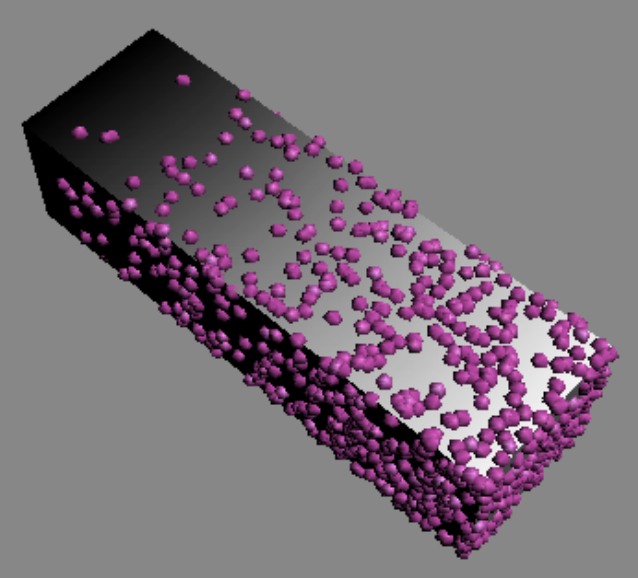
The box emitter is mapped with a gradient. With Position Object set to Density By
Material > Grayscale, the particles appear with greater frequency in the lighter
areas of the box.
■Opacity Particles are more likely to appear on opaque areas than on
transparent areas.
■Grayscale & Opacity Combines the two: More particles appear on light,
opaque areas than on dark, transparent areas.
■Red/Green/Blue Considers only the specified color channel. The higher
its value at any given pixel, the more likely particles are to appear there.
Use Sub-Material When on, uses a sub-material from the Multi/Sub-Object
material assigned to the emitter to define density values.
This option allows usage of “invisible” materials for particle placement. If the
emitter uses a Multi/Sub-Object material but its geometry doesn't use the ID
Particle Flow | 2779
that corresponds to one of the sub-materials, the sub-material doesn't appear.
However, the operator can use it to calculate the density of particle placement.
The software assumes the material to be applied to the entire object surface.
Mtl ID Specifies the material ID of the sub-material to be used for particle
emission.
Separation When on, the software attempts to keep the particles apart by
the amount specified in Distance. The likelihood of successfully separating
particles depends on the number of particles, the specified distance, and the
Attempts Max value.
Distance Specifies the distance, in system units, by which the software should
try to keep the particles separate. Default=1.0.
Distinct Points Only Limits emission to a specific number of points (see Total,
below) on the specified Location type.
Emission points are still randomized; change the Uniqueness setting to alter
these.
Total Sets the number of emission points. Available only when Distinct
Points Only is on. Default=10.
If Location Is Invalid group
Delete Particles When on, if the software cannot place a particle according
to the current option, it deletes the particle. When off, particle placement is
undefined; that is, it depends on other variables. Default=off.
If the number of particles is more important than the position on the object,
leave this off. However, if exact placement is of higher priority than the
number of particles, turn Delete Particles on.
Uniqueness group
The Uniqueness setting enables randomization of placement on the emitters.
Seed Specifies a randomization value.
New Calculates a new seed using a randomization formula.
Attempts Max When using the Separation option, this specifies the maximum
number of times Particle Flow will try to set particle positions that maintain
the requested distance. If unsuccessful within this number of attempts, particles
might be closer together than the requested distance. Also affects placement
with Density By Material using either of the Grayscale options.
2780 | Chapter 12 Space Warps and Particle Systems
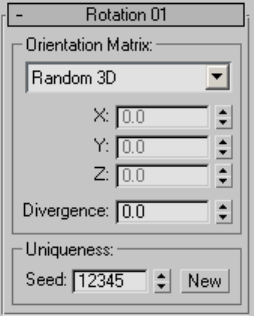
Rotation Operator
Particle View on page 2730 > Click a Rotation operator in an event or add a
Rotation operator to the particle system and then select it.
The Rotation operator lets you set and animate particle orientation during an
event, with optional random variation. You can apply orientation in any of
five different matrices: two random and three explicit. For some options you
can set a degree of random variation or divergence from the specified
orientation.
To cause particles to spin, use the Spin operator on page 2783 .
Interface
The user interface appears in the parameters panel, on the right side of the
Particle View dialog.
Orientation Matrix group
The Orientation Matrix setting includes options that give particles random
orientations, or let you specify orientation in any of three different ways.
Default=Random 3D.
Random 3D Gives each particle an arbitrary, random 3D orientation.
Random Horizontal Gives each particle an arbitrary, random 3D orientation
about the Z axis only. Rotation about the X and Y axes doesn't change (unless
Divergence is used), so the particles remain vertical.
World Space Orientation is specified in the world coordinate space.
Particle Flow | 2781
Use the X/Y/Z settings to specify the orientation for all particles.
Speed Space The coordinate space for particle orientation is determined by
the particles' direction upon entering the event.
By default, using the Speed operator on page 2791 > Along Icon Arrow option,
particles are aimed straight down when born.
Use the X/Y/Z settings to specify the orientation for all particles.
Speed Space Follow The coordinate space for particle orientation is
determined continually while the particles are in the event. Thus, by default,
particles constantly reorient themselves to “aim” in the direction they're
traveling.
For example, if you add a Find Target test on page 2891 to the end of the default
Event 01, move the target sideways, and set Rotation to Speed Space Follow,
the particles start out pointing straight down, as oriented by the Speed
operator, and then gradually reorient themselves to point in the direction
they're traveling: toward the target.
Use the X/Y/Z settings to specify the orientation for all particles. The
Divergence setting is unavailable when using Speed Space Follow.
X/Y/Z Set the basic orientation about the particles' local axes. Unavailable
with the Random 3D and Random Horizontal options.
Divergence Defines the range of variation (in degrees) for particle orientation.
The actual deviation is calculated at random within this range. Unavailable
with the Random 3D or Speed Space Follow option. Default=0.0.
Restrict Diverg[ence] To Axis When on, lets you use the Divergence Axis
controls to set the axis to which divergence will be applied. When off, the
software uses a random axis for each particle. Unavailable with the Random
3D or Speed Space Follow option. Default=off.
Divergence Axis Use the X/Y/Z settings to set the axis to which divergence
will be applied. Default=1,0,0. Range=-1.0 to 1.0.
To specify one of the world axes, set the corresponding parameter to any
non-zero value, and the others to 0. A negative value flips the axis. The numeric
values come into play when you want to use an axis that's not aligned with
the X, Y, or Z axis. In that case, you specify multiple non-zero values whose
effect is relative to one another. For example, if you want the axis to be
oriented halfway between the positive X and Y axes, you would set X and Y
to the same positive amount. The actual value doesn't matter. Similarly, to
set the axis to 30 degrees (1/3 of the angle) from the X axis to the Y axis, you'd
2782 | Chapter 12 Space Warps and Particle Systems
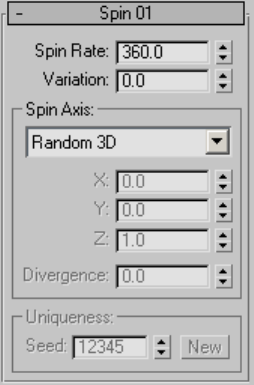
set the Y value to twice that of the X value. For example, X=0.2 and Y=0.4, or
X=0.5 and Y=1.0.
Uniqueness group
The Uniqueness setting affects the randomization of orientation with the
Random 3D and Random Horizontal options, and also Divergence.
Seed Specifies a randomization value.
New Calculates a new seed using a randomization formula.
Spin Operator
Particle View on page 2730 > Click a Spin operator in an event or add a Spin
operator to the particle system and then select it.
The Spin operator gives an angular velocity to particles in an event, with
optional random variation. Spin is applied once per event per particle, except
when using the Speed Space Follow option; however, the settings can be
animated.
To simply specify particle orientation, use the Rotation operator on page 2781
.
Interface
Particle Flow | 2783
The user interface appears in the parameters panel, on the right side of the
Particle View dialog.
Spin Rate The rate of revolution in degrees per second.
Variation The maximum amount, in degrees per second, by which the spin
rate can vary. The actual variation is calculated once, at random, for each
particle.
Spin Axis group
The Spin Axis setting includes options that let you apply the spin on a random
or specific axis, with optional random variation of the spin axis.
Default=Random 3D.
Random 3D Spins each particle about an arbitrary, random 3D axis.
World Space The spin axis is specified in the world coordinate space.
Use the X/Y/Z settings to specify the spin axis.
Particle Space The spin axis is specified in the local coordinate space of each
particle.
Use the X/Y/Z settings to specify the spin axis.
Speed Space The coordinate space for particle orientation is determined by
the particles' direction upon entering the event.
The X axis is aligned with the particle direction, while the Z axis is
perpendicular to the X axis and is pointed upward with respect to world space
as much as possible.
Use the X/Y/Z settings to specify the orientation for all particles.
Speed Space Follow The coordinate space for particle orientation is
determined by the particles' direction throughout the event. Use this option
to allow particles that change direction during the event to keep the spin axis
aligned with their direction.
The X axis is aligned with the particle direction, while the Z axis is
perpendicular to the X axis and is pointed upward with respect to world space
as much as possible.
Use the X/Y/Z settings to specify the orientation for all particles.
X/Y/Z Use these to set the spin axis. Unavailable for the Random 3D option.
Default=0,0,1. Range=-1.0 to 1.0.
To specify a single axis, set the corresponding parameter to any non-zero
value, and the others to 0. A negative value flips the axis, and reverses the
2784 | Chapter 12 Space Warps and Particle Systems
direction of rotation. The numeric values come into play when you give more
than one axis a non-zero value, in which case their effect is relative to one
another. For example, if you want the spin axis to be oriented halfway between
the positive X and Y axes, you would set X and Y to the same positive amount.
The actual value doesn't matter. Similarly, to set the spin axis to 30 degrees
(1/3 of the angle) from the X axis to the Y axis, you'd set the Y value to twice
that of the X value. For example, X=0.2 and Y=0.4, or X=0.5 and Y=1.0.
Divergence Defines the range of variation (in degrees) for spin-axis
orientation. The actual deviation is calculated at random within this range.
Unavailable for the Random 3D option. Default=0. Range=0 to 180.
Uniqueness group
The Uniqueness setting affects the randomization of spin rate variation, spin
axis with the Random 3D option, and Divergence with the other options.
Seed Specifies a randomization value.
New Calculates a new seed using a randomization formula.
Scale Operator
Particle View on page 2730 > Click a Scale operator in an event or add a Scale
operator to the particle system and then select it.
The Scale operator lets you set and animate particle size during an event, with
optional random variation. Options for how scaling and animation are applied
give this operator a great deal of flexibility.
Procedures
Example: To animate particle scale:
This procedure gives an overview of animating particles to grow for 30 frames,
remain at full size for the next 30 frames, and then shrink for 30 frames. It
also gives an option for having the particles pulsate in size during the middle
period. To follow this procedure, you should be familiar with the basic usage
of Particle Flow and Track View.
1Set up a default Particle Flow system. Set the Shape operator to Sphere,
and set the Display operator to Geometry.
2Add a Send Out test to Event 01.
Particle Flow | 2785
3Add a new Scale operator to the event display, creating a new event. Set
the new event's Display operator to Geometry, and make sure it's a
different color than the one in Event 01.
4Wire the Send Out test in Event 01 to Event 02.
5In the Event 02 > Scale operator, set Type to Absolute, and animate the
Scale Factor values from 10 to 100 over frames 0 to 30. In the Animation
Offset Keying group, set Sync By to Event Duration.
6Add an Age Test to Event 02. Set it to Event Age, set Test Value to 30, and
Variation to 0.
In this event, particles grow from 10 percent of their original size to full
size over the first 30 frames of their existence, which is the same as their
duration in the event. At that point, they'll be eligible to move to the
next event.
7Use a new Scale operator to create a new event, Event 03. Set the new
event's Display operator to Geometry, and make sure it's a different color
than the others.
8Wire the Age Test in Event 02 to Event 03.
9In the Event 03 > Scale operator, Set Type to Absolute, and in the
Animation Offset Keying group, set Sync By to Event Duration.
10 Copy and paste the Age Test as an instance from Event 02 to Event 03.
Particles in Event 03 remain at full scale for 30 frames, and then move
on to the next event.
11 Use a new Scale operator to create a new event: Event 04. Set the new
event's Display operator to Geometry, and make sure it's a different color
than the others.
12 Wire the Age Test in Event 03 to Event 04.
13 In the Event 04 > Scale operator, set Type to Absolute, and animate the
Scale Factor values from 100 to 10 over frames 0 to 30. In the Animation
Offset Keying group, set Sync By to Event Duration.
14 Copy and paste the Age Test as an instance from Event 03 to Event 04.
In this event, particles shrink from full size to 10 percent of their original
size over 30 frames.
15 Play the animation.
Next, you'll use a Noise controller to cause the particles in Event 03 to
pulsate in size.
2786 | Chapter 12 Space Warps and Particle Systems
16 Add a second Scale operator to Event 03, below the existing Scale operator.
Set it to Relative Successive, and set Sync By to Event Duration.
The name of this operator should be Scale 04.
17 In Particle view, right-click the Scale Factor X % parameter field on the
Scale 04 rollout, and choose Show In Track View.
The Curve Editor opens with the X Scale Factor parameter highlighted.
18 Right-click the X Scale Factor item and choose Assign Controller from
the menu.
19 In the Assign Float Controller dialog, double-click Noise Float.
The Noise Controller dialog opens.
20 Set Strength to 200, and to the right of Strength, turn on the >0 check
box.
21 Copy this controller, and then paste it as instances to Y Scale Factor and
Z Scale Factor.
Although the Scale operator defaults to constraining all scale factors to
the same value, thus scaling particles uniformly, changing controllers in
Track View works on a per-parameter basis.
22 Play the animation.
This time, the particles grow in size for 30 frames, then pulsate in size
for the next 30 frames, and then shrink from the size at the end of Event
03 to 10 percent of that over the next 30 frames.
Particle Flow | 2787
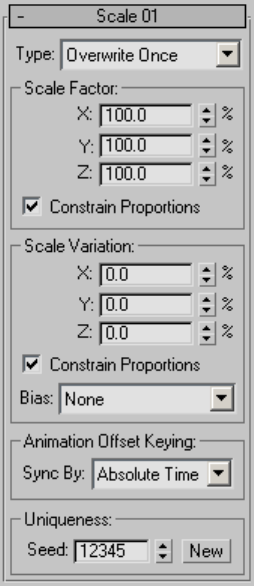
Interface
The user interface appears in the parameters panel, on the right side of the
Particle View dialog.
Type
The scaling Type setting includes options that let you scale particles once in
an event or repeatedly, and apply scaling as an absolute or relative factor.
Default=Overwrite Once.
Overwrite Once Sets the scale one time only as an absolute percentage value,
disregarding any previous scaling.
To produce a range of different birth sizes, and specify the scaling explicitly,
use Overwrite Once with animated scale factors.
Inherit Once Sets the scale one time only as a percentage of existing scaling.
The existing scaling should be specified with a previous Scale operator, the
2788 | Chapter 12 Space Warps and Particle Systems

Scale setting in the Shape operator on page 2821 , or a Shape Instance operator
on page 2825 .
For instance, if you previously used Scale with Overwrite Once to scale particles'
birth size within a range, and then want to scale them to half their previous
size, use Inherit Once and set Scale Factor to 50%.
Absolute Sets the scale continuously, while the particle is in the event, as an
absolute percentage value, disregarding any previous scaling.
Use Absolute if you want to animate the particles' scale explicitly.
Relative First Sets the scale continuously, while the particle is in the event, as
a percentage of existing scaling. The existing scaling should be specified with
a previous Scale operator, or a Shape Instance.
Use Relative First when you want to scale the particles relative to the scaling
at which they enter the event, and optionally animate the scaling, or before
a Relative Successive operator.
Relative Successive Scales the particles continuously, relative to scaling set
earlier in the same event.
NOTE Always precede Relative Successive in the same event with an operator
that modifies the scale channel all the time, such as a Scale operator set to Absolute
or Relative First, or a Shape Instance operator with the Scale check box turned on
(it's on by default).
Scale Factor group
The operator performs scaling on each particle's local axes. It can scale particles
on a single axis or on any combination of axes.
X/Y/Z Sets the scaling as a percentage of the particle's current size. To scale
uniformly, turn on Constrain Proportions, and then change any axis setting.
Range=0 to 10000000. Default=100.
Constrain Proportions When on, retains the current ratio of scale factor
settings, so that changing any axis setting changes all of them. Default=on.
Scale Variation group
X/Y/Z Sets the scaling variation as a percentage of the particle's previous
size. To scale uniformly, turn on Constrain Proportions, and then change any
axis setting. Range=0 to 100. Default=0.
Constrain Proportions When on, retains the current ratio of scale variation
settings, so that changing any axis setting changes all of them. Default=on.
Particle Flow | 2789
Bias Lets you choose how to distribute the scaling variation within the
specified range or ranges. Default=None.
■None No bias; scaling variation is distributed equally through the range.
■Centered Scaling variation is concentrated near the middle of the range;
that is, at 0.0%.
With this choice, scaling will occur more frequently with low percentage
values than with ones near the values you set. In other words, most scaling
variants will be close to the specified scaling value.
■Towards Minimum Scaling variation is concentrated near the lower end
of the range (base-variation); that is, most scaling variants will be smaller
than the scaling value.
■Towards Maximum Scaling variation is concentrated near the upper end
of the range (base+variation); that is, most scaling variants will be larger
than the scaling value.
Animation Offset Keying group
If you animate the Scale Factor or the Scale Variation settings or both, the
software can begin applying this animation to all particles as of the start frame
of the animation or the first frame of the current event, or to each particle
based on its age. For instance, if you set Sync By to Particle Age, and set Scale
Factor keys at frames 0 and 30, then the software will animate the scaling
factor for each particle between its birth and its 30th frame of existence, if the
particle is in the scaling event or a prior event. Following this example, any
particle that has already reached its 30th frame of existence before reaching
the event will enter the event fully scaled. That is, the software will apply the
Scale Factor value that you set at frame 30 to each particle aged 30 or above
at the moment it enters the scaling event. However, any particle that leaves
the scaling event before reaching age 30 will stop scaling as of its exit frame.
In other words, with respect to particles in other events, animation of action
parameters is retroactive, but not post-active.
Alternatively, if you set Sync By to Absolute Time, the scaling is animated
from frame 0 to frame 30 of the animation, regardless of particle age, and even
if no particles are in the event at that time. Or, if you set Sync By to Event
Duration, the scaling animation is applied to each particle as of the time that
it enters the event.
2790 | Chapter 12 Space Warps and Particle Systems
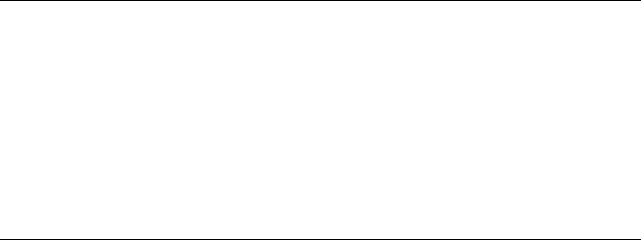
NOTE With the Overwrite Once and Inherit Once scaling types, scaling always
occurs with respect to the entire animation; that is, in Absolute Time mode. Thus,
when either of those scaling types is in effect, the Sync By setting is unavailable.
Also, if you animate Scale Factor or Scale Variation when using Overwrite Once
or Inherit Once, it doesn't cause scaling animation in the particles, but rather
applies one-time scaling to particles born during that period. For instance, if you
animate Scale Factor on all three axes from 100% to 200% over frames 0 to 30,
particles born at frame 0 are normal size, particles born at frame 15 are
one-and-one-half times normal size, and particles born at frame 30 (and thereafter)
are twice normal size.
Sync By Choose the time frame for applying animated parameters:
■Absolute Time Any keys set for parameters are applied at the actual frames
for which they're set.
■Particle Age Any keys set for parameters are applied at the corresponding
frames of each particle's existence.
■Event Duration Any keys set for parameters are applied to each particle
starting when it first enters the event.
Uniqueness group
The Uniqueness setting affects the randomization of scale variation.
Seed Specifies a randomization value.
New Calculates a new seed using a randomization formula.
Speed
Speed Operator
Particle View on page 2730 > Click Speed in an event or add a Speed operator
to the particle system and then select it.
This is the default Speed operator, which appears in the first event when you
create a new Particle Flow icon. It provides basic controls over particle speed
and direction.
Directional controls provided by the Speed operator are based on the position
and orientation of the Particle Flow icon. For best results when using other
Particle Flow | 2791

objects as emitters, use the Speed By Surface Operator on page 2806 operator
instead.
See also:
■Speed By Icon Operator on page 2796
■Keep Apart Operator on page 2815
Procedures
Example: To change particles' speed:
The Speed operator works on an instantaneous basis: It sets each particle's
speed once only, when it enters the event. Even if you animate the Speed
value, each particle moves at a constant rate of speed, defined by the value at
the time it enters the event. This procedure demonstrates a trick you can use
to change particle speed with an animated Speed value, thanks to Particle
Flow's looping ability.
1Create a default particle system, and position it at the top of the
Perspective viewport.
2Play the animation.
The particles fall downward at the default rate: 300 units per second.
3Add a Send Out test at the bottom of Event 01.
4Add a Speed operator to an empty area of the event display.
This creates a new event.
5 Turn on Auto Key, and move the time slider to frame 30.
6In Particle View, click the new Speed 02 operator, and then in the Particle
View parameters panel, set Speed to 0.
This animates the Speed value from 300 at frame 0 to 0 at frame 30.
7 Turn off Auto Key.
8Wire the Send Out test in Event 01 to Event 02.
9Play the animation.
The particles born later move slower, but all still move at a constant rate
of speed.
2792 | Chapter 12 Space Warps and Particle Systems
10 Add a Send Out test at the end of Event 02.
11 Create a new event using an Age Test. Click the Age Test to display its
parameters, and then set the following:
■Event Age
■Test Value=1
■Variation=0
12 Wire the Send Out test in Event 02 to Event 03.
13 Wire the Age Test in Event 03 to Event 02.
14 Play the animation.
All the particles slow down simultaneously and eventually come to a
stop.
Here's how it works: As each particle enters Event 02, its speed is set to
the current Speed value in the Speed operator. Particle Flow then sends
the particle immediately to Event 03, where it sits for one frame. Event
03 then returns the particle to Event 02, whose Speed value is now lower.
Particle Flow perceives the returned particle as newly entering the event,
so it changes its speed to the current Speed value. Thus, the particles
continually return to Event 02 one frame later than before, and are
assigned a progressively lower speed.
If you wanted the particles to do something else after they stop, you could
add a Speed Test to Event 02, above the Send Out test, set Test True If
Particle Value to Is Less Than Test Value, and set Test Value to a very low
value, such as 0.01. Then wire the Speed Test to a different event.
Particle Flow | 2793
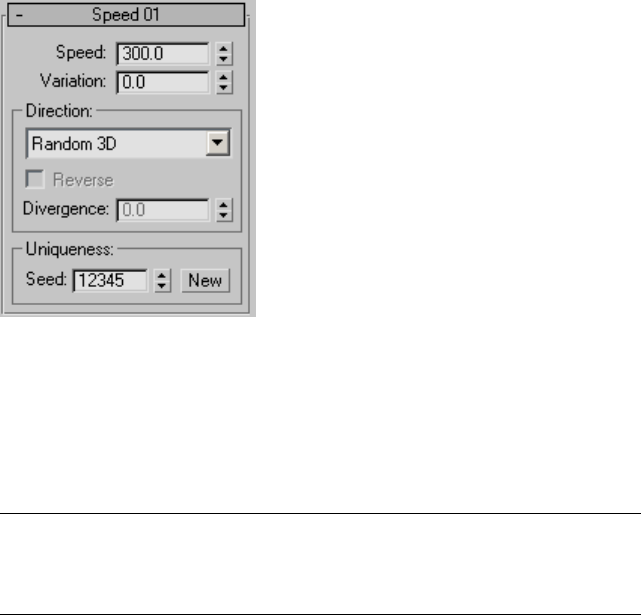
Interface
The user interface appears in the parameters panel, on the right side of the
Particle View dialog.
Speed The particle speed in system units per second. Default=300.
A positive Speed value moves the particles in the direction determined by the
Direction setting; a negative Speed value moves the particles in the opposite
direction.
NOTE Speed sets each particle's speed once only: when the particle enters the
event (or is born, in the case of a birth event). If you animate the Speed value,
particle speed does not vary: rather, each particle is given a constant speed equal
to the current Speed value when it enters the event.
Variation The amount by which particle speed can vary, in system units per
second. Default=0.0.
To obtain each particle's speed, the system multiplies the Variation value by
a random number between -1.0 and 1.0, and then adds the result to the Speed
value. For example, if Speed=300 and Variation=100, then each particle's speed
would be between 200 and 400.
Direction group
The Direction drop-down list lets you specify which way the particles go after
they're born. Default=Along Icon Arrow. In most cases, the actual direction
also depends on the icon orientation. The primary exception is when Position
> Location is set to Pivot.
2794 | Chapter 12 Space Warps and Particle Systems
Particle movement is always in a straight line unless influenced by other
factors.
Along Icon Arrow Particles move parallel to the icon arrow. Rotate the icon
to change the direction.
Icon Center Out Each particle moves along an imaginary line drawn between
the particle's location and the icon center.
With the flat icon types (Rectangle and Circle), this results in all the particles
moving in one plane, unless you increase Divergence above 0.0. With icons
that have height (Box and Sphere), the particles move outward in three
dimensions.
Particles at the center, as is the case when the Position operator's Location
parameter is set to Pivot, arbitrarily move along the world X axis.
Icon Arrow Out Each particle moves along an imaginary line drawn between
the particle's location and the icon arrow. The line is perpendicular to the
icon arrow, which is considered an infinite line for this purpose.
With the flat icon types (Rectangle and Circle), this results in all the particles
moving in one plane, unless you increase Divergence above 0.0. With icons
that have height (Box and Sphere), the particles move outward in a cylindrical
formation.
Random 3D Particles move in all directions. This option is affected by the
Uniqueness setting.
Random Horizontal Each particle moves in a random horizontal direction;
that is, parallel to the world XY plane. This option is affected by the
Uniqueness setting.
Inherit Previous Uses the current direction of motion.
If you choose Inherit Previous but no direction was previously specified, the
speed and direction are undefined; the particles don't move.
Reverse When on, the direction is reversed. Default=off.
Using Reverse is the equivalent of multiplying the Speed value by -1. This
option is unavailable if Random 3D or Random Horizontal is chosen.
Divergence When on, spreads out the particle stream. Use the numeric
setting to define the extent of the divergence, in degrees. Range=0 to 180.
Default=0. The value can be animated.
This option is unavailable if Random 3D is chosen.
Particle Flow | 2795
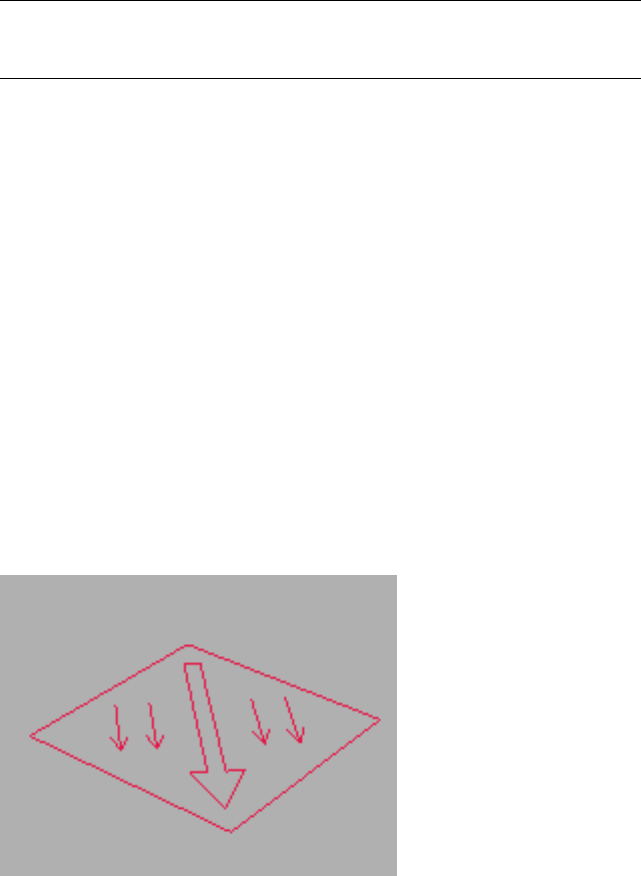
TIP For a fountain-like spray, set Position > Location to Pivot, set Direction to
Along Icon Arrow, set Divergence to the desired angle, and rotate the icon so its
arrow points upward.
Uniqueness group
The Uniqueness setting enables randomization of speed variation, and
randomization of direction with the Random 3D and Random Horizontal
options.
Seed Specifies a randomization value.
New Calculates a new seed using a randomization formula.
Speed By Icon Operator
Particle View on page 2730 > Click Speed By Icon in an event or add a Speed
By Icon operator to the particle system and then select it.
Click a Speed By Icon operator icon in the viewport > Modify panel
Create panel > Helpers > Particle Flow > SpeedByIcon
The Speed By Icon operator lets you use a special, non-rendering icon to
control particle speed and direction.
Speed By Icon operator icon
When you add a Speed By Icon operator to the particle system in Particle
View on page 2730 , the Speed By Icon operator icon icon appears in the scene
at the world origin (0,0,0). When animated, the operator icon's motion is
2796 | Chapter 12 Space Warps and Particle Systems

imparted to the particles. If you delete the icon, the software also deletes the
operator.
NOTE If you add Speed By Icon from the Create panel, Particle Flow creates a
separate event for the operator in the particle diagram.
WARNING If you delete a Speed By Icon operator icon in the viewport, you also
delete the corresponding operator in the Particle Flow system.
See also:
■Speed Operator on page 2791
■Speed By Surface Operator on page 2806
■Keep Apart Operator on page 2815
Procedures
To use the Speed By Icon operator:
1Add a Speed By Icon operator to an event. Be sure to add it after any
existing Speed operators in the event. Alternatively, delete or turn off
any existing Speed operators.
The Speed By Icon operator icon appears at the world origin (0,0,0).
2Animate the icon as you would any object. You can do this manually, or
with a controller such as Path Constraint. See the following procedure
for an example of this.
The particles' motion is now under the influence of the animated icon.
3Set the Speed By Icon parameters. With the icon selected, you can do this
in the Modify panel.
In general, the default Icon Animation > Sync By setting, Event Duration,
works best. It causes the icon animation to be applied to the particles
within the time frame of the event containing the Speed By Icon operator.
Example: To send particles along a path:
1Reset the software, and then add a Particle Flow system in the Perspective
viewport.
Particle Flow | 2797
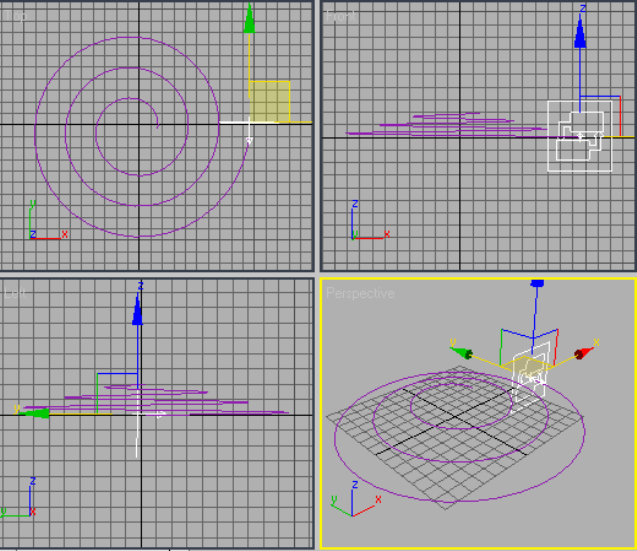
2On the Create panel, choose Shapes > Splines > Helix, and then, in the
Perspective viewport, at the center of the grid, create a helix shape. Then,
on the Parameters rollout, set the following:
■Radius 1=100
■Radius 2=20
■Height=20
■Turns=3
■Bias=0
This will serve as the particle path.
3Move and rotate the Particle Flow source icon so that it's at the start of
the helical path, and aimed along the path, as shown. Get the base of
the arrow as close as possible to the start of the path.
4Open Particle View (press 6).
2798 | Chapter 12 Space Warps and Particle Systems

5In Event 01, click the Position Icon operator and set Location to Pivot.
This causes the particles to be emitted in a thin stream.
6Insert a Speed By Icon operator at the end of Event 01.
The operator icon appears at the world origin.
7Select the operator icon, and then, from the Animation menu, choose
Position Controllers > Path Constraint on page 3222 .
When you move the mouse cursor into the viewport, a rubber-band line
joins the cursor to the icon.
8Select the Helix object.
The command panel switches to the Motion tab, and the controls indicate
that the software has applied a Position List controller to the icon, with
the listed controllers being a Position XYZ and a Path Constraint. You
can delete the former if you like, but it doesn't make any difference for
the purposes of this procedure.
9Close Particle View, and then drag the time slider back and forth between
its extents a few times.
TIP The best way to view the results is from the Top viewport.
The particles follow the path fairly closely, but diverge noticeably at the
end of the path, where the turns are tightest. Correcting divergence in
tight turns typically requires an increase in the acceleration limit.
Particle Flow | 2799
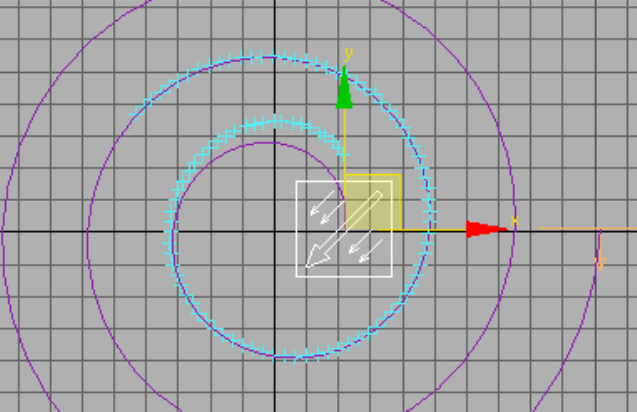
The particle stream diverges from the path at its endpoint.
10 Stop at frame 100.
This will let you see the results of changing the Speed By Icon parameters
as you make the changes.
11 Open the Modify panel, and, if necessary, select the Speed By Icon
operator icon.
The operator parameters appear on the Modify panel. This is the case
with any action that uses a unique icon, and lets you adjust the parameters
without using Particle View.
12 On the Parameters rollout, use the Accel Limit spinner to slowly increase
the value as you observe the changes to the particle path.
As you approach a value of 150, the end of the particle path comes closer
and closer to the Helix. You shouldn't see much change above 150.
2800 | Chapter 12 Space Warps and Particle Systems
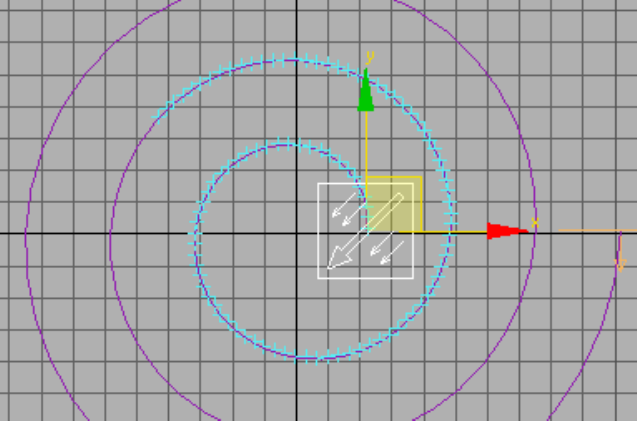
The endpoints now coincide.
13 Drag the time slider again.
The particle path remains similar to that of the Helix for the entire
duration of the animation. With other setups, you might need to use
different values for Influence %, and for paths with tight twists and turns,
you might need to increase Accel Limit as well.
You might be wondering why you didn't simply replace the default Speed
operator with the Speed By Icon operator. To see why not, try this:
14 Go to frame 100, open Particle View, and click the Speed 01 operator's
icon to turn it off. Play the animation.
The entire particle path is offset from the Helix, so it's difficult to tell
how closely it follows the latter's curves.
15 Try adjusting the Speed By Icon's Accel Limit and Influence % setting to
get the particles to follow the helical path more closely.
It's not easy. You get more reliable results using the Speed operator to set
the initial speed, and then Speed By Icon to set the particle path.
Particle Flow | 2801

To use the Use Icon Orientation option:
The Use Icon Orientation option applies arc-like motion to the particles based
on rotation animation of the icon. To best understand how it works, it's
necessary to isolate its influence by eliminating any potentially conflicting
factors.
1Reset the software, and then add a Particle Flow system in the Perspective
viewport. Set its position to the world origin: (0,0,0).
2Open Particle View and click the Birth operator. Set Emit Stop=0.
This causes all particles to appear at frame 0.
3Click the Speed operator and press the Delete key to delete it.
4Drag a Speed By Icon operator from the Depot to the end of Event 01.
The Speed By Icon operator icon appears at the world origin.
5 Select the Speed By Icon operator icon, and then right-click
the icon and choose Rotate from the menu. Go to frame 20, turn on Auto
Key, and rotate the icon 180 degrees about the X axis.
6 Turn off Auto Key.
7Drag the time slider.
The particles aren't affected by the icon animation.
Because the Speed By Icon operator icon is selected, the operator's
parameters appear on the Modify panel.
8On the Modify panel, turn on Use Icon Orientation. Drag the time slider
again.
This time, the particles move in unison with the icon rotation, as if they
were glued to an infinite plane coincident with the icon.
9Go to frame 10, select the Particle Flow source icon (not the Speed By
Icon operator icon), and then right-click the icon and choose Move from
the menu. Move the icon straight up, on the Z axis, about 100 units.
As you drag upward, the particles move away from the icon.
10 Drag the time slider again. This time the particles move in an arc around
the icon.
2802 | Chapter 12 Space Warps and Particle Systems
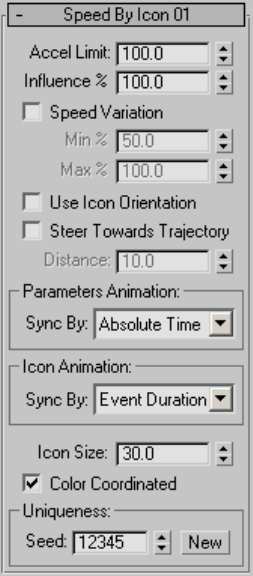
11 Try moving and rotating the two icons, playing the animation each time
you make a change. Also set Emit Stop back to 30.
As you can see, the possibilities with just this simple setup are myriad.
In combination with the many other variables and options in Particle
Flow, they're endless.
Interface
The user interface appears in the parameters panel, on the right side of the
Particle View dialog. When the icon is selected, the parameters also appear
on the Modify panel.
Accel(eration) Limit The maximum amount, in system units per second per
second, by which the particles' speed can change in order to match the speed
of the operator icon. Default=100.0.
If the operator icon changes speed or direction rapidly, increase this value to
let the particles follow it more closely.
Particle Flow | 2803

TIP Use a lower Accel Limit value for smooth motion, and a higher value when
greater accuracy is needed, such as when the particles should hit a small target.
You can animate this setting (use Sync By > Event Duration) to specify different
appropriate values, depending on the required results.
Influence % Determines the mix of the previous speed with the speed of the
operator icon. Default=100.0. Range=0.0 to 100.0.
At the default value of 100, the speed is controlled only by that of the icon.
At 0, the icon speed doesn't affect particle speed at all. At in-between values,
the mix proportion is determined by the Influence % value.
Speed Variation Enables random variation of the particles' speed, so they
don't all move at exactly the same rate as the icon. Turn this on, and then set
the minimum and maximum percentages of variation. Default=off.
Using Speed Variation can help keep the particles from bunching up as they
travel along the animation path. Note, however, that each individual particle's
speed doesn't vary; it travels at a constant speed.
Min %/Max % Set the minimum and maximum percentages, respectively,
of particle speed variation. Default=50.0 (Min %), 100.0 (Max %).
For example, if you set Min % to 50 and Max % to 200, the particles will vary
in speed between half and two times the speed of the icon.
Use Icon Orientation Applies animation of the icon's orientation to the
particles.
By default, Speed By Icon controls particle motion only by animation of the
icon's position. If you turn on Use Icon Orientation, the software also applies
rotation of the icon to the particle motion. In essence, this motion is circular,
and its extent depends on the distance between each particle and the icon.
Default=off.
The best way to understand how this works is by using it. To try out Use Icon
Orientation, see this procedure on page ? .
Steer Towards Trajectory Particles farther away than the Distance value from
the icon are moved directly toward the icon. Default=off.
Distance Sets the distance between the particles and the operator icon beyond
which Steer Towards Trajectory takes effect. Default=10.0.
Parameters Animation group
If you animate the operator settings, the software can begin applying this
animation to all particles as of the start frame of the animation or the first
2804 | Chapter 12 Space Warps and Particle Systems
frame of the current event, or to each particle based on its age. For instance,
if you set Sync By to Particle Age, and set Speed Variation keys at frames 0
and 30, then the software will animate the speed variation for each particle
born while the event is active between its birth and its 30th frame of existence.
Alternatively, if you set Sync By to Absolute Time, the speed variation is
animated from frame 0 to frame 30 of the animation, even if no particles are
in the event at that time. Or, if you set Sync By to Event Duration, the speed
variation animation is applied to each particle as of the time that it enters the
event. For further information, see Animation Offset Keying group on page
2790 .
Sync By Choose the time frame for applying animated parameters:
■Absolute Time Any keys set for parameters are applied at the actual frames
for which they're set.
■Particle Age Any keys set for parameters are applied at the corresponding
frames of each particle's existence.
■Event Duration Any keys set for parameters are applied to each particle
relative to the frame at which it first enters the event.
Icon Animation group
The software can begin applying animation of the Speed By Icon operator
icon to all particles as of the start frame of the animation or the first frame of
the current event, or to each particle based on its age. For an explanation, see
Animation Offset Keying group on page 2790 .
Sync By Choose the time frame for applying animation of the icon to the
particles:
■Absolute Time Any keys set for icon motion are applied at the actual
frames for which they're set.
■Particle Age Any keys set for icon motion are applied at the corresponding
frames of each particle's existence.
■Event Duration Any keys set for icon motion are applied to each particle
relative to the frame at which it first enters the event.
Icon Size Sets the size of the operator icon. This setting is for visibility only;
it doesn't affect particle behavior.
Particle Flow | 2805

Uniqueness group
The Uniqueness setting enables randomization of the speed variation range.
Seed Specifies a randomization value.
New Calculates a new seed using a randomization formula.
Speed By Surface Operator
Particle View on page 2730 > Click Speed By Surface in an event or add a Speed
By Surface operator to the particle system and then select it.
The Speed By Surface operator lets you control particle speed and direction
with any object or objects in the scene. This is in contrast to the default Speed
operator on page 2791 , which uses the Particle Flow icon to control particle
speed and direction. Speed By Surface also provides options for controlling
speed by materials in the scene, and continuous speed control.
Typically, you use Speed By Surface to assign speed and direction characteristics
based on the objects used as emitters with the Position Object operator on
page 2773 . That is, you assign the same objects as emitters with Position Object
and as Surface Geometry objects with Speed By Surface.
TIP For greater control over particle motion on the surface, apply a Speed operator
on page 2791 before the Speed By Surface operator in the same event. Use the
Speed operator to specify particle direction on the surface, and the Speed By
Surface operator to adjust the vertical component of the speed vector to follow
the contour of the surface.
See also:
■Speed By Icon Operator on page 2796
■Keep Apart Operator on page 2815
2806 | Chapter 12 Space Warps and Particle Systems
Procedures
Example: To use Speed By Surface:
The Speed By Surface operator offers a wealth of possibilities for usage. This
procedure will lead you through several examples, but you're encouraged to
explore the operator further on your own to learn more about it.
1Start or reset the software, and add a Particle Flow system. Position the
source icon at the world origin (X/Y/Z=0), and set the icon's Length and
Width values both to 30.
2Add a Cylinder primitive to the scene. Position it above the source icon:
X/Y=0 and Z=30. Set Radius=20 and Height=40.
3Play the animation, and then stop.
The particles move downward, using the default starting setup.
4Open Particle View and add a Speed By Surface operator to the end of
Event 01. Click the operator in the event to display its parameters panel
in Particle View.
5In the Surface Geometry group, click Add, and then select the cylinder.
6Play the animation again, and then stop.
The particles still move downward.
7Go to frame 15, so you can see the particles, and then slowly move the
cylinder downward along the Z axis, while watching the particles in the
Perspective and Front viewports. Stop when the emitter is above the
cylinder.
As the bottom of the cylinder passes below the emitter, more and more
particles start moving on the XY plane rather than perpendicular to it.
That's because they eventually become closer to one of the vertical sides
of the cylinder, rather than the bottom, at which point they move
perpendicular to the vertical sides. When the top becomes the closest
side, the particles again move vertically, but upward instead of downward.
8Move the cylinder back up until the emitter is at its vertical center. Then,
on the Modify panel, click the lower part of the Sides spinner to decrease
the number of sides, one at a time.
Each time you click, the particle streams traveling outward change, to
move perpendicular to the vertical sides as they change position. You
might also try rotating the cylinder, and note that the particle streams
also rotate, like the spokes of a wheel.
Particle Flow | 2807
9In the Speed By Surface parameters, change Direction to Out Of Surface,
and then move the cylinder up and down.
The overall behavior doesn't change much. Out Of Surface becomes more
useful when you use the Control Speed Continuously option, as you'll
observe shortly.
10 In the Speed By Surface parameters, change Direction to Parallel To
Surface, and then move the cylinder up and down.
Now the particle behavior is effectively opposite of that with the other
two options. When the particles are closer to the top or bottom, they
move along the XY plane, and when they're closer to the vertical sides,
they move downward. If you want them to move upward instead, set
Speed to a negative value.
Next, you'll discover how the Control Speed Continuously option alters
particle behavior.
11 In the Speed By Surface parameters, choose Control Speed Continuously,
and then drag the time slider.
The particles spread out from the emitter, and then start orbiting the
cylinder in a roughly cylindrical overall formation. The software
continually checks to see which side of the cylinder a particle is closest
to, and, if necessary, changes its direction to make it travel parallel to
that side. You can affect the size of the particles' orbits by changing their
speed.
Lastly, you'll see how to contain particle motion within the cylinder.
12 Make the cylinder considerably larger: Radius=60 and Height=90. Activate
the Perspective viewport, if necessary, and then press F3 to set it to
Wireframe view.
13 In Particle View, click the Speed 01 operator and set Direction to Random
3D.
14 Click the Speed By Surface operator. Set Speed to 300 if necessary. In the
Direction group, choose Out Of Surface, and then drag the time slider.
After exiting the emitter, the particles always move away from the nearest
surface, with the result that they end up milling about in the center of
the cylinder.
15 Gradually increase the Speed value, up to 1,000 or so.
The particles start to spread out vertically, and eventually start moving
so fast that they escape the cylinder. You can make them stay inside the
2808 | Chapter 12 Space Warps and Particle Systems
cylinder by letting them accelerate more quickly, so they can turn before
moving past the nearest surface.
16 Increase the Accel Limit setting until the particles no longer exit the
cylinder.
17 Try giving the particles more room to move about in by increasing the
size of the emitter. Also try changing other settings throughout the particle
system to see their effects. The possibilities don't end here, and the more
you experiment, the more you'll learn about how this powerful operator
works.
Particle Flow | 2809

Interface
2810 | Chapter 12 Space Warps and Particle Systems

The user interface appears in the parameters panel, on the right side of the
Particle View dialog.
The first setting lets you choose whether the operator controls speed once or
continuously.
Set Speed Once The operator sets the speed for each particle once: when
the particle enters the event.
Control Speed Continuously The operator sets particle speed throughout
the event. When you choose this option, the Continuous Speed Control
group on page 2814 becomes available.
Speed The particle speed in system units per second. Default=300.
With the Control Speed Continuously option, you can turn off Speed. This
causes Particle Flow to use the current particle speed.
Using a negative Speed value causes particles to move in the opposite direction
of that effected by a positive speed.
Variation The amount by which particle speed can vary, in system units per
second. Default=0.0.
To obtain each particle's speed, the system multiplies the Variation value by
a random number between -1.0 and 1.0, and then adds the result to the Speed
value. For example, if Speed=300 and Variation=100, then each particle's speed
would be between 200 and 400.
Surface Geometry group
Use these controls to assign objects to affect particle speed and direction. The
list in this group shows the objects, or reference geometry, that the operator
uses to control speed and direction.
If you don't assign any objects, the current particle speed and direction are
not affected.
You can assign multiple Surface Geometry objects, but if they're not all emitters
as well, the results can be difficult to interpret. In general, assign the same
objects as Surface Geometry that your system uses as emitters.
TIP For optimal performance, when moving particles with respect to high-polygon
objects, create a low-poly proxy version to use as surface geometry, link it as a
child of the high-poly object if necessary, and then hide the low-poly proxy.
Use the Add and Remove buttons to edit this list.
Particle Flow | 2811

Add Adds an object to the list. Click Add, and then click an object in the
viewport.
By List Adds multiple objects to the list. Click By List to open the Select
Surface Objects dialog. This works just like Select From Scene on page 168 :
Highlight the objects to use to control speed and direction, and then click the
Select button.
Remove Removes an object from the list. Highlight the object in the list,
and then click Remove.
Animated Shape Turn on to allow particles to follow the surface of an object
whose form is animated by morphing or with modifiers.
Subframe Sampling When on, the operator acquires animation of the Surface
Geometry shape on a tick basis (every 1/4,800th of a second) rather than a
frame basis. This provides greater precision in allowing the particle positions
to follow animation of the Surface Geometry object's form.
Speed by Material Varies particles' existing speed and direction based on
properties of the material applied to each Surface Geometry object. For
example, if an object is assigned a black-and-white checkered diffuse map and
you choose the Grayscale Multiplier option, particles near the white-checked
areas move faster than those from the black-checked areas.
NOTE For material-influenced speed to appear properly in the viewports, two
conditions are required: at least one viewport must be set to a shaded display
mode, and the material or map must have Show Map In Viewport turned on in
the Material Editor.
The options are as follows:
■Grayscale Multiplier Lets material luminance control speed, with darker
areas producing slower particles and lighter areas producing faster ones.
The software multiplies the luminance of the material near each particle,
converted to a percentage, by the particle's current speed. A luminance of
0 converts to 0%, of 128 converts to 50%, and of 255 converts to 100%.
For example, if the speed of a particle traveling at 50 units per second is
influenced by a pixel whose luminance is 90, the resulting speed is
90/255*50, or about 17.6 units per second.
■Signed Grayscale Works like Grayscale Multiplier, but the multiplier can
be negative as well, causing reversal of motion. Signed Grayscale uses a
material luminance value of 128 as the midpoint, and assigns it a multiplier
of 0%. Luminance values from 0 to 127 result in multipliers of -100% to
2812 | Chapter 12 Space Warps and Particle Systems
about -1%, respectively, and values of 129 to 255 result in multipliers of
about 1% to 100%, respectively.
■RGB as World XYZ Mult. Works like Grayscale Multiplier, but uses the
intensity of the material's red, green, and blue channels to affect particle
speed on the world X, Y, and Z axes, respectively. So, for example, if the
material pixel is pure red, that is, its RGB value is (255,0,0), then the particle
will retain its current speed on the world X axis, but its speed on the Y and
Z axes will be reduced to 0. Similarly, a medium-yellow pixel (128,128,0)
will cause speed on the world X and Y axes to be reduced by half, and will
cut speed on the Z axis to 0.
■RGB as Local XYZ Mult. Works like RGB as World XYZ Mult., but uses
the object's local coordinates rather than world coordinates.
Use Sub-Material When on, uses a sub-material from the Multi/Sub-Object
material assigned to the Surface Geometry object to define speed.
This option allows usage of “invisible” materials for controlling particle speed.
If the emitter uses a Multi/Sub-Object material but its geometry doesn't use
the ID that corresponds one of the sub-materials, the sub-material doesn't
appear. However, the operator can use it to calculate the density of particle
placement. The software assumes the material to be applied to the entire object
surface.
Mtl ID Specifies the material ID of the sub-material to be used for particle
speed control.
Direction group
The Direction drop-down list lets you specify which way the particles go after
they're born. Default=Surface Normals. In most cases, the actual direction also
depends on the icon orientation. The primary exception is when Position >
Location is set to Pivot.
Particle movement is always in a straight line unless influenced by other
factors.
Surface Normals Each particle moves along a line perpendicular to the nearest
face. The direction the surface faces doesn't matter.
Out Of Surface Particles move away from the closest face.
Particle Flow | 2813
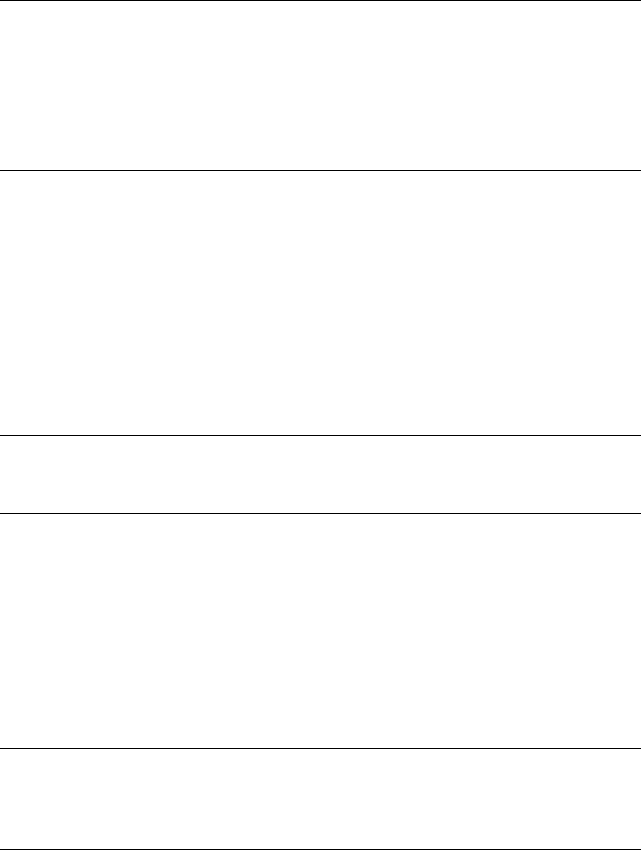
TIP You can use this option to confine particles to the interior of an object. Position
the emitter inside the object, designate the object as the Surface Geometry, choose
Control Speed Continuously, and choose Out Of Surface. Each time a particle
comes close to a surface, it turns to travel directly away from the surface. Control
the particles' travel range with the Speed setting, but keep in mind that particles
moving very fast might “escape” their container. If this happens, increase the
Accel Limit setting; this lets the particles turn more quickly.
Parallel To Surface Each particle travels parallel to the nearest face.
To make particles orbit an object, use this with Control Speed Continuously,
and set appropriate Continuous Speed Control values (see the following
section).
Divergence When on, spreads out the particle stream. Use the numeric
setting to define the extent of the divergence. Range=0 to 180. Default=0. The
value can be animated.
This option is unavailable if Control Speed Continuously is chosen.
TIP For a fountain-like spray, set Position > Location to Pivot, set Direction to
Along Icon Arrow, set Divergence to the desired angle, and rotate the icon so its
arrow points upward.
Continuous Speed Control group
When you choose the Control Speed Continuously option, these controls
become available. Basically, these controls let the particles move about within
the region of the Surface Geometry object rather than in a straight line away
from the emitter.
Accel Limit Sets the maximum acceleration. The higher this value, the more
quickly particles can turn and change speed.
TIP Use a lower Accel Limit value for smooth motion, and a higher value when
greater accuracy is needed, such as when the particles should hit a small target.
You can animate this setting (use Sync By > Event Duration) to specify different
appropriate values, depending on the required results.
Unlimited Range When on, the surface controls speed and direction of
particles at any distance. When off, particles must be within a specified range.
Default=on.
2814 | Chapter 12 Space Warps and Particle Systems
Range The maximum distance, in system units, between the particles and
controlling surface. The Surface Geometry will not control particles beyond
this distance.
Falloff Zone The distance, in system units, beyond the Range value within
which the Surface Geometry exerts partial control over particles. The degree
of control diminishes from 100% at the Range distance to 0% at the
Range+Falloff Zone distance.
Animation Offset Keying group
Choose the time frame for applying animated parameters. For an explanation,
see Animation Offset Keying group on page 2790 .
Absolute Time Any keys set for parameters are applied at the actual frames
for which they're set.
Particle Age Any keys set for parameters are applied at the corresponding
frames of each particle's existence.
Event Duration Any keys set for parameters are applied to each particle
starting when it first enters the event.
Uniqueness group
The Uniqueness setting enables randomization of speed variation, and
randomization of direction with the Random 3D and Random Horizontal
options.
Seed Specifies a randomization value.
New Calculates a new seed using a randomization formula.
Keep Apart Operator
Particle View on page 2730 > Click Keep Apart in an event or add a Keep Apart
operator to the particle system and then select it.
The Keep Apart operator, a member of the Speed operator family, lets you
apply forces to particles to cause them to separate, in order to prevent or
minimize collisions among particles. Alternatively, you can use a negative
force to keep particles from separating too much. The operator works by
controlling particle speed and acceleration.
Particle Flow | 2815

NOTE Keep Apart doesn't use particle geometry; rather, it creates a spherical force
field centered on the pivot of each particle. You can adjust the size of the force
field by changing the particle size.
TIP In certain cases, the default settings might not be sufficient to keep particles
from interpenetrating. For increased separation, use higher values for Force and
Accel Limit, choose Relative To Particle Size, and increase the Core % value.
See also:
■Speed Operator on page 2791
■Speed By Surface Operator on page 2806
■Speed By Icon Operator on page 2796
Script Wiring rollout
This rollout appears in the parameters panel below the main operator rollout
after you highlight the operator, right-click it, and then choose Use Script
Wiring. Thereafter, a check mark appears next to the Use Script Wiring in the
right-click menu, and the rollout appears whenever you highlight the operator.
To turn off script wiring, choose Use Script Wiring again from the right-click
menu.
Script wiring lets you use a script to control the Force and Range parameters,
which you normally specify in the operator's parameters. Place a Script
operator on page 2874 before the Keep Apart operator in the event, and then
use it to define values in the particleFloat and particleVector channels. For an
example of a script that sets particleFloat values, see particleFloat Sample
Script on page 2868 .
On the Script Wiring rollout, choose either of the following:
Use Script Float As Choose either of the following:
■Not Used Particle Flow uses the Force setting on page 2819 specified in
the Parameters rollout.
■Influence Particle Flow applies the script particleFloat value to the Force
value.
2816 | Chapter 12 Space Warps and Particle Systems
Use Script Vector As Choose one of the following. Choosing Absolute Size
Range or Relative Size Range makes the Range settings on the Parameters
rollout unavailable.
■Not Used Particle Flow uses the Range on page 2819 settings specified in
the Parameters rollout.
■Absolute Size Range Particle Flow applies the script particleVector values
to the Absolute Size Range values. The X component of the vector value
is used for the core radius, and the Y component for the falloff radius.
■Relative Size Range Particle Flow applies the script particleVector values
to the Relative Size Range values. The X component of the vector value is
used for the core percent, and the Y component for the falloff percent.
Particle Flow | 2817

Interface
The user interface appears in the parameters panel, on the right side of the
Particle View dialog.
2818 | Chapter 12 Space Warps and Particle Systems

Force The amount of force applied to the particles. Use positive values to
separate particles, or negative values to move them closer together.
Default=100.0
Accel(eration) Limit When on, lets you set a maximum acceleration value
that can be applied to particles' motion. When off, the software uses any
necessary acceleration. Default=on, 1000.0.
TIP Use a lower Accel Limit value for smooth motion, and a higher value when
greater accuracy is needed, such as when the particles should hit a small target.
You can animate this setting (use Sync By > Event Duration) to specify different
appropriate values, depending on the required results.
Speed Limit When on, lets you set a maximum speed value that can be
applied to particles' motion. When off, the software uses any necessary speed.
Default=off, 600.0.
Range group
You can set a volume and falloff within which the force takes effect, either as
absolute distances or relative to particle size. Default=Absolute Size.
Absolute Size Choose this to set the core radius and falloff zone as absolute
distances, in system units.
Core Radius The distance from each particle's pivot point, in system units,
within which the force is applied at full strength. Default=10.0
Falloff Zone The distance beyond the core radius, in system units, over which
the force diminishes from full strength to 0. Default=10.0
Relative to Particle Size Choose this to set the core radius and falloff zone
as percentages, relative to the radius of each particle. The particle radius is
determined by measuring the distance from the pivot point to the farthest
corner of its bounding box.
Core % The distance from each particle, as a percentage of the particle radius,
within which the force is applied at full strength. Default=200.0
Falloff % The distance beyond the core radius, as a percentage of the radius,
over which the force diminishes from full strength to 0. Default=100.0
Variation % The amount by which range values can vary randomly, as a
percentage of the specified values. The software uses the same random variation
value for both Core and Falloff values, whether absolute or relative. Default=0.0
For example, if you choose Absolute Size, set Core Radius to 40 and Falloff
Zone to 20, and set Variation % to 50, then each particle's actual core radius
Particle Flow | 2819
will be a random number in the range 20 to 60, and the falloff zone a random
number in the range 10 to 30. For each particle, the software uses the same
Variation % value, so if Core Radius is determined to be 20, then Falloff Zone
would be 10.
Scope group
By default, the Keep Apart force keeps particles only in the current event (that
is, the event that contains the Keep Apart operator) apart from each other
when used locally, or particles in each event in the current flow on page 7787
apart when used globally. These settings let you alternatively keep particles
away from particles in other events or flows without affecting the behavior
of latter. Default=Current Event.
Current Event Keeps particles in the current event only away from each
other.
When used globally, keeps particles in each event in the current flow apart
from each other, but not apart from particles in other events in the flow.
Current Particle System Keeps particles in the current event away from each
other, and away from all other particles in the current flow on page 7787 . The
particles not in the current event are not influenced by the Keep Apart operator.
When used globally, keeps apart and influences all particles in the current
flow.
Selected Events Keeps particles in the current event away from all particles
in the events highlighted in the list below this choice. Particles not in the
current event are not influenced by the Keep Apart operator.
When used globally, keeps all particles in the current flow apart from all
particles in the events highlighted in the list below this choice, but influences
only particles in the current flow.
After choosing this option, click items in the list to highlight them.
Selected Particle Systems Keeps particles in the current event away from all
particles in the flows on page 7787 highlighted in the list below this choice.
The particles not in the current event are not influenced by the Keep Apart
operator.
When used globally, keeps all particles in the current flow apart from all
particles in the flows highlighted in the list below this choice, but influences
only particles in the current flow.
After choosing this option, click items in the list to highlight them.
2820 | Chapter 12 Space Warps and Particle Systems
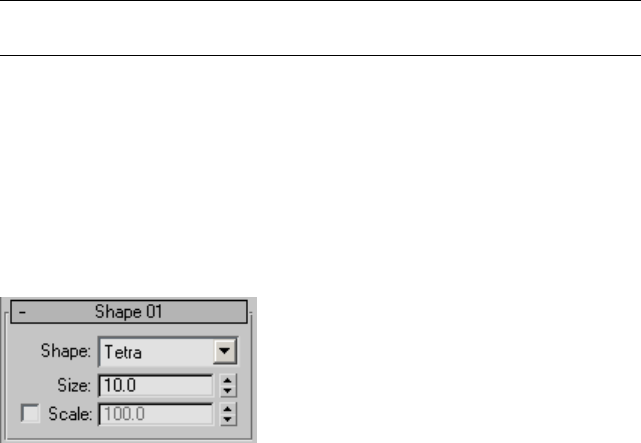
Uniqueness group
The Uniqueness setting enables randomization of the Range on page 2819 >
Variation % calculations.
Seed Specifies a randomization value.
New Calculates a new seed using a randomization formula.
Shape
Shape Operator
Particle View on page 2730 > Click Shape in an event or add a Shape operator
to the particle system and then select it.
Shape is the default operator for defining the geometry used in the particle
system. You can use it to specify particles in the shape of pyramids, cubes,
spheres, or vertices, as well as particle size.
NOTE All primitive particles created with Shape have pivot points in their geometric
centers.
See also:
■Shape Instance Operator on page 2825
■Shape Facing Operator on page 2822
■Shape Mark Operator on page 2832
Interface
Particle Flow | 2821

Shape Sets the shape of the particles to Vertex or one of three geometric
primitives. Default=Pyramid.
■Vertex Use this option to create non-rendering particles whose sole
attribute is their location. This can be useful when using script operators.
■Tetra These tetrahedron-shaped particles have a four triangular sides.
Having only four polygons, the tetra is the simplest of the rendering particle
shapes.
■Cube These box-shaped particles have six square sides, all the same size.
■Sphere Creates spherical particles. The sphere has the most polygons of
the rendering particle shapes, and its orientation isn't obvious.
Size Sets the overall size of the particles in system units. Default=10.0
Setting Size=0 makes the particles invisible.
Scale Turn on to set the size of the particles as a percentage of the Size value.
Use the numeric field to set the Scale percentage value. Default=100.
Scale is animatable, while Size is not. Also, turning on Scale creates the scale
data that any Scale operators further on in the flow can work with.
Shape Facing Operator
Particle View on page 2730 > Click Shape Facing in an event or add a Shape
Facing operator to the particle system and then select it.
The Shape Facing operator creates each particle as a rectangle that always faces
a particular object, camera, or direction. For effects like smoke, fire, water,
bubbles, or snowflakes, use Shape Facing with a material containing appropriate
opacity and diffuse maps.
By default, the particles' top and bottom sides are parallel to the horizontal
plane. The Orientation setting lets you change this default alignment.
NOTE For the Shape Facing operator to be able to calculate the particle orientation,
it must know the current particle position. For this reason, always place the Shape
Facing operator below a Position operator in an event.
See also:
■Shape Operator on page 2821
2822 | Chapter 12 Space Warps and Particle Systems
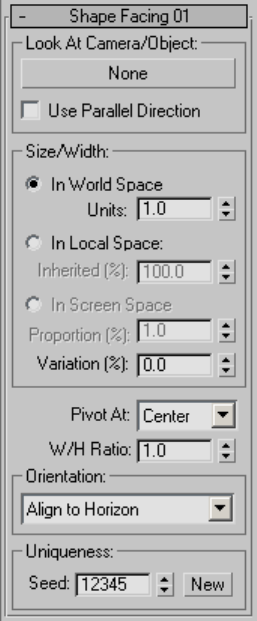
■Shape Instance Operator on page 2825
■Shape Mark Operator on page 2832
Interface
Look At Camera/Object group
Use this control for defining the camera or object toward which the particle
will face. This object is known as the Look At object. For the technically minded,
the facing is maintained by keeping each particle's local Z axis pointed at the
Look At object, or when Use Parallel Direction is on, aligned with the vector
between the Particle Source icon and the Look At object.
Name After picking a Look At object, its name appears here.
Particle Flow | 2823
Pick Camera or Object Click this button, and then select a camera or object
in the scene to use as the Look At object. The mouse cursor changes to a cross
shape when positioned over a valid object.
Use Parallel Direction When off, all particles continuously rotate to stay
facing toward the Look At object. Each particle's orientation varies because
its location differs from those of the others. When on, all particles face in the
same direction, defined by an imaginary line between the Particle Source
gizmo center and the Look At object. Default=off.
Size/Width group
Use these settings to specify the coordinate system for setting the size, as well
as the size parameters. The numeric settings in this group are not animatable.
In World Space Sets the absolute size in system units, using the World
coordinate system.
Units With the In World Space option, sets the particle size in system units.
Range=0 to 1000000000. Default=1.
In Local Space Sets particle size relative to the existing size, in local space.
The software uses the dimensions of the existing shape to determine the size
of the “facing rectangle.”
Inherited % Sets the facing particles' size as a percentage of the existing size.
Range=0 to 100. Default=100.
In Screen Space Sets the facing particles' size as a percentage of the screen
width. The actual size of each particle changes as necessary throughout the
animation, depending its distance from the camera, to maintain a constant
size from the camera's point of view.
This option is available only when the Look At object is a camera, and Use
Parallel Direction is off.
Proportion % Sets the particle size as a percentage of the screen width.
Default=1.
Variation % Sets the percentage by which particle size can vary. Default=0.
Pivot At Specifies the part of the particle around which rotation is performed
when maintaining the facing direction. The choices, available from the
drop-down list, are Top, Center, and Bottom. Default=Center.
With Top and Bottom, the center of the corresponding side is used as the
particle center for rotation.
2824 | Chapter 12 Space Warps and Particle Systems
This option is useful, for example, when particles are lying on a surface, and
each particle is an explosion. In this situation, you'd probably want the entire
particle rectangle to appear above the surface, so you'd set Pivot At to Bottom.
W/H Ratio Defines the aspect (width-to-height) ratio of the shape rectangle.
Adjust this ratio to that of the particle-map imagery. For the commonly used
TV aspect ratio of 4:3, set W/H Ratio=1.33. The parameter is not animatable.
Range=0.001 to 1000. Default=1 (square particles).
This value is not animatable.
Orientation
Use this drop-down list to choose how particles rotate on the axes not specified
by the Look At direction. Default=Align to Horizon.
Align to Horizon Keeps the top edge aligned with the horizon (the world
XY plane).
Align to Speed Follow Uses the right side of each particle as the leading edge,
so the top and bottom edges are aligned with the direction of particle motion.
Random Orients the top edge at random.
Allow Spinning To spin the particles, choose this option, and in the same
event use a Spin operator on page 2783 . In the latter, set Rotation Axis to Particle
Space and use the default axis values: X=0, Y=0 , Z=1.
Uniqueness group
The Uniqueness setting enables changing the randomization of the size/width
variation.
Seed Specifies a randomization value.
New Calculates a new seed using a randomization formula.
Shape Instance Operator
Particle View on page 2730 > Click Shape Instance in an event or add a Shape
Instance operator to the particle system and then select it.
Shape Instance lets you use any reference object on page 7910 in the scene as
particles. You can effectively define only one reference object per event, but
the object can comprise any number of sub-objects, each of which Particle
Flow can treat as a separate particle. Also, using tests, you can divide the
Particle Flow | 2825

particle stream into multiple branches and define a different particle shape
for each.
As the name of the operator indicates, reference geometry is instanced into
the particle system. Thus, any physical changes you make to the original
geometry are reflected instantly in the particle system. If you hide the original
geometry, the particles still appear. However, if you delete the original
geometry, the particles are deleted as well.
Using Transform-Animated Reference Objects
You can create animated particle shapes by animating the reference object
with modifiers, and then turning on Animated Shape on page 2831 . However,
Shape Instance ignores any rotational and positional transformations applied
directly to the reference object; it uses only the pure scale component. For
example, if you scale an object non-uniformly using the View reference
coordinate system, the result might skew the object's shape. Because the
skewing is the by-product of a rotational transform, it wouldn't be reflected
in the particles' shape. However, modifiers and comparable functions that
contain transformations applied to the reference object are reflected in the
instanced particles. For example, if you want particles to use rotational
transforms applied to the reference object, use the Reset XForm function on
the reference object. Reset XForm is available from the Utilities panel.
TIP Particle Flow can , however, use rotational and positional animation applied
to descendant objects in a hierarchy, when you use the entire hierarchy as a single
particle. To do this, create a hierarchy, animate the descendant objects, and then
designate the parent as the reference object. Do not turn on Separate Particles
For > Object And Children. You'll find a procedure illustrating this, below.
When using an animated reference object, it is recommended that you hide
the reference object after instancing it in the particle system.
See also:
■Shape Operator on page 2821
■Shape Facing Operator on page 2822
■Shape Mark Operator on page 2832
2826 | Chapter 12 Space Warps and Particle Systems

Procedures
Example: To use the reference object's rotational and positional animation
in the particle system:
1Create an object you want to use as the particle shape, such as a teapot,
and a Dummy helper object.
2Animate the teapot using the Move and Rotate tools.
3 Use the Align tool to center the teapot to the dummy.
This step isn't necessary, but it can help to obtain more consistent results.
4 Link the teapot as a child of the dummy (drag from the teapot to
the dummy).
You can use any object as the parent, but using a dummy, which doesn't
render, lets you animate all instanced particles visible in the final
animation.
5Create a default Particle Flow system.
6In Particle View, delete the Rotation operator.
7Replace the Shape operator with a Shape Instance operator.
8In the Shape operator parameters, designate the dummy as the Particle
Geometry Object.
9Turn on Animated Shape.
10 For sequential animation, which can be more interesting visually, in
Animation Offset Keying, set Sync By to Particle Age or Event Duration.
Particle Flow | 2827
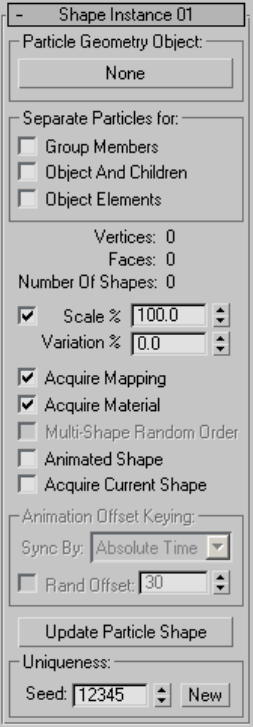
Interface
Particle Geometry group
Use this control for defining the object to be used as the particle geometry.
This object is known as the reference object.
[button] Click this button, and then select a geometry object in the scene
to be used as the particle shape. The mouse cursor changes to a cross shape
when positioned over an object that's valid for use as a reference object. Valid
2828 | Chapter 12 Space Warps and Particle Systems
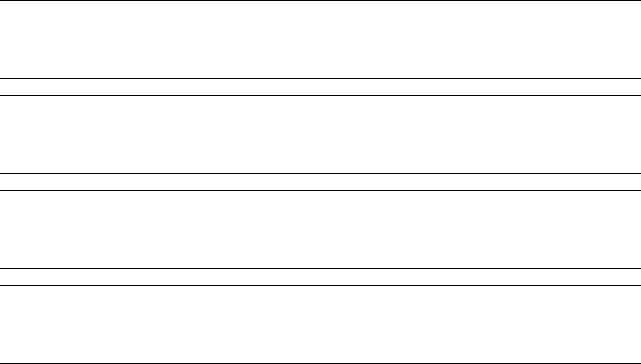
objects include multi-shape objects such as groups and hierarchies; see Separate
Particles For group on page 2829 .
After picking a reference object, its name appears on the button.
You can use almost any geometry object as a reference object. By default, the
operator automatically converts closed splines to rendering geometry by “filling
in” the area defined by the shape outline. To use the shape outline instead,
select the original shape and, on the Modify panel > Rendering rollout, turn
on Display Render Mesh. You needn't turn on Renderable, but changes to all
other Rendering rollout settings, such Thickness and Sides, are reflected in
the rendered particles.
Particle Flow does not automatically “fill in” open shapes such as Line
(non-closed) and Arc. To render these shapes when using them as particles,
turn on Modify panel > Rendering rollout > Display Render Mesh.
If a Shape Instance operator is in effect for which the geometry object is not
defined, and the viewport display type is set to Geometry, then the particles
appear in the viewports as X characters.
NOTE If a multi-shape object used as a reference object comprises objects both
with and without materials applied, and Acquire Material is on, Particle Flow will
apply the first available material to any objects without materials applied.
NOTE You can use a NURBS surface as a reference object, but not a NURBS curve.
To use a NURBS curve as particle geometry, first convert it to a surface using a
method such as the Cap function.
TIP For best results, when using an animated reference object, it's highly
recommended that you hide the original object before rendering, or use Object
Properties to turn off its Renderable check box.
NOTE If using a group as a reference object, make sure the group is closed before
selecting it. Selecting an open group will add only the group member you click,
not the entire group.
Separate Particles For group
3ds Max provides a number of methods for combining disparate objects into
single entities, including grouping, building hierarchies with linking, and
attaching. By default, when using such a multi-shape object as particle geometry,
each particle comprises all member objects. Alternatively, you can instruct
Particle Flow to treat each member object as a separate particle with these
options. When on, the software uses each member object as a single particle,
Particle Flow | 2829
in left-to-right order according to its X-axis position, by default. So, for
example, if you create text in the Front viewport, assign it as reference
geometry, and turn on Object Elements, the letters come out in the proper
order.
You can vary the order randomly by turning on Multi-Shape Random Order
on page 2831 .
You can turn on any combination of Separate Particles items. All are off by
default.
Group Members When on, group members are treated as separate particles.
Object and Children When on, linked objects are treated as separate particles.
Object Elements When on, element sub-objects of a single mesh object are
treated as separate particles.
Vertices/Faces Show the number of vertices and triangles per particle. If the
reference geometry is multi-shape and the appropriate check boxes in the
Separate Particles are on, then these displays show an average vertex/face
count.
Number of Shapes Shows number of different particle shapes. This number
is always 1 unless the reference geometry is multi-shape and the appropriate
check boxes in the Separate Particles For group are on, in which case this
displays the number of resulting different shapes.
Scale (%) Specifies a uniform scaling factor for all particles. Range=0 to
100000. Default=on, 100.
The center of scaling for multi-shape object members treated individually
depends on how the objects are combined. For grouped and linked objects,
the scaling is done about the objects' pivot points. For object elements, the
scaling center is the geometric center of each object; that is, the averaged
location of all the vertices.
This value cannot be animated. To animate particle size, use the Scale operator
on page 892 .
Variation (%) Specifies a randomized percentage of scaling variation. Use
the Uniqueness setting to change the randomization. Range=0 to 100.
Default=0.
This value cannot be animated. To animate scaling variation, use the Scale
operator on page 2785 operator.
Acquire Mapping When on, all mapping data from the reference object is
transferred to particles. Default=on.
2830 | Chapter 12 Space Warps and Particle Systems

Acquire Material When on, material data from the reference object is
transferred to particles. Default=on.
If the reference object is a group, with different materials applied to the group
members, the software creates a new Multi/Sub-Object material containing
all of the materials and uses it as the particle material.
TIP Because materials are “sticky” in Particle Flow, if you turn off Acquire Material
after specifying a reference object with an attached material, the material remains
applied to the particles. To avoid applying the instanced shape's material to the
particles, turn off Acquire Material before specifying the reference object.
Multi-Shape Random Order When on, assigns shapes to particles in random
order. When off, Particle Flow emits each shape in the multi-shape object as
a single particle, in the order of the shape's X coordinate. In other words, the
shape with the lowest X-axis coordinate is emitted first, then the one with
the next highest, and so on. The option is available only if at least one of
Separate Particles For group check boxes is on. Default=off.
For example, if you want the particles to spell out a word or phrase, use
extruded text created in the Front viewport as the reference object, turn on
Separate Particles For > Group Elements, but leave Multi-Shape Random Order
off.
Animated Shape When on, particles use any animation in the reference
object, including cyclic animation applied with the Parameter Curve
Out-of-Range Types controls. When off, the particles are not animated.
With this option, you can use the Animation Offset Keying controls to specify
how to synchronize the reference-object animation with the particles. See the
next section.
NOTE A particle that uses this option is animated only while in the event containing
the Shape Instance operator. If it moves to another event that doesn't contain a
shape operator, it keeps the same shape, but the animation stops. The easiest way
to keep the animation going from event to event is to place the Shape Instance
operator in the global event on page 7801 . Otherwise, you need to place the
operator in each event in which the particle should be animated.
Acquire Current Shape When on, Particle Flow acquires the particle shape
from the reference object as each particle enters the event. Thus, if the reference
object is animated, particles that enter at different times get different shapes.
However, these shapes are not animated. When the option is off, the shape
is acquired from frame 0. Default=off.
This option is available only when Animated Shape is off.
Particle Flow | 2831
Animation Offset Keying group
These controls are available only when Animated Shape is on.
Sync By Lets you choose how to synchronize reference-object animation
with the particles.
■Absolute Time All particles have the same shape at any given moment.
■Particle Age Animation of the reference object is synchronized with
particle age: Frame 0 of the reference-object animation corresponds to the
frame of each particle's birth.
■Event Duration Frame 0 of the reference-object animation corresponds
to the moment the particle enters the event.
Rand Offset When on, randomly varies the start of each particle's animation.
Use the numeric setting to specify the number of frames by which the
animation start can vary.
Update Particle Shape Refreshes instanced particle shapes from the reference
object. Use this after changing an object in a hierarchical reference object.
In most cases, Particle Flow automatically updates instanced particles when
changes are made to the reference object. However, in some cases, when you
change an object deep in a hierarchy, the particle instances might not be
updated. In such a case, click Update Particle Shape to refresh the instances.
Uniqueness group
The Uniqueness setting enables changing the randomization of the scale
variation, animation offset, and the multi-shape random order.
Seed Specifies a randomization value.
New Calculates a new seed using a randomization formula.
Shape Mark Operator
Particle View on page 2730 > Click Shape Mark in an event or add a Shape Mark
operator to the particle system and then select it.
Use the Shape Mark operator to replace each particle with either a rectangle
or a box cut out from the particle geometry with an image mapped onto it.
2832 | Chapter 12 Space Warps and Particle Systems
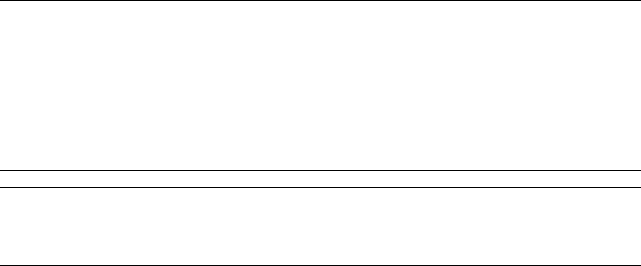
The image can be animated and the animation can be synchronized with
particle events.
A typical application of Shape Mark would be to leave marks after particles
impact objects in the scene. For example, when a torpedo hits a boat and
explodes, you could use Shape Mark to leave scorch marks on the boat surface.
TIP By default, the mark left by Shape Mark is always rectangular, no matter what
shape the particles are. To leave a differently shaped mark, choose the Shape
group > Rectangle option, and use a material on page 2839 in the same event with
transparent areas to define the mark's outline. For example, apply a Mask map to
the material's Opacity channel, and to the map's Mask channel, apply a bitmap
containing an alpha channel. On the Bitmap Parameters rollout, set Mono Channel
Output to Alpha.
NOTE With its default settings, the Shape Mark operator can generate coplanar
faces, which the mental ray renderer cannot render well. If you want to use mental
ray rendering with Shape Mark, adjust the operator's settings as follows:
■In the Shape group, choose Box Intersection.
■Set Surface Offset to 0.01.
■Set Offset Variation to 0.005.
■Set Vertex Jitter to 0.002.
With these settings, faces are no longer coplanar, and the mental ray renderer
gives better results.
See also:
■Shape Operator on page 2821
■Shape Instance Operator on page 2825
■Shape Facing Operator on page 2822
Procedures
Example: To use Shape Mark:
1Determine which object is to receive the marks; this will be the contact
object. Apply a deflector to this object.
Particle Flow | 2833
2Set up your particle system with an event that causes particles to collide
with the contact object deflector.
3At the end of this event, add a Collision test on page 2881 .
4In the Collision test, designate the deflector from step 1.
5Create a new event with the Shape Mark operator, and wire the Collision
test to this event.
6In the Shape Mark operator > Contact Object group, designate the object
from step 1. Change the other Shape Mark settings as necessary.
Now, when the particles strike the contact object, they disappear, leaving
marks on the object.
If you want the particles to bounce after leaving marks, rather than
disappearing, use a Collision Spawn test on page 2885 instead, and turn
off its Delete Parent check box. The spawned particles become the marks,
and the original particles remain in the first event.
7Optionally, add a Material operator to define the surface characteristics
of the marks.
2834 | Chapter 12 Space Warps and Particle Systems

Interface
Particle Flow | 2835

Contact Object group
Use this control for defining the object on which marks are to be left.
[button] Click this button, and then select an object in the scene to use as
the contact object. The mouse cursor changes to a cross shape when positioned
over a valid object.
After picking a contact object, its name appears on the button.
Align to Surface Animation When on, Shape Mark takes into account surface
changes due to vertex animation of the contact object. If Shape on page 2837
is set to Rectangle, then the mark changes its orientation and position to
appear be stuck to the surface of the contact object. If Shape is set to Box
Intersection, then the mark changes shape along with that of the contact
object. When off, only transformation of the contact object is taken into
consideration. Default=off.
Turn this on only if there is significant vertex animation at the contact point,
such as with an animated water surface.
WARNING This option requires significant CPU and memory resources.
Orientation group
Align To Depending on the setting for Shape on page 2837 , Shape Mark creates
either a rectangle or a box cutout on the contact geometry. The Orientation
setting specifies how the shape is oriented. In the mark's local coordinate
system, the X axis is Length, the Y axis is Width, and with the box cutout, Z
is height. The Z axis is perpendicular to the surface of the object at the contact
point.
The alignment choices are as follows:
■Speed The Length direction is parallel to the projection of the particles'
speed vector onto the contact plane.
■Particle X/Y/Z The Length direction is parallel to the projection of the
particle's local coordinate axis X, Y, or Z, respectively, as the particle moves
toward the contact object.
■Random Uses a random Length direction in the contact plane.
Divergence Applies a range of random variation, in degrees, to the orientation
of the Length direction. Unavailable when using the Random option.
2836 | Chapter 12 Space Warps and Particle Systems
Size group
Use these settings to specify the coordinate system for setting the size of the
mark, as well as the size parameters. The numeric settings in this group are
not animatable.
In World Space Sets the absolute size of the mark in system units, using the
World coordinate system.
Width/Length With the In World Space option, sets the particle dimensions
in system units. Range=0 to 1000000000. Default=1.0.
In Local Space Sets the mark size relative to the existing particle size, in local
space. The software uses the dimensions of the existing shape to determine
the size of the “facing rectangle.”
Inherited % Sets the percentage of the mark size, relative to the existing
particle size. Range=0 to 100. Default=100.0.
Variation % Sets the percentage by which particle size can vary. Default=0.0.
Impact Angle Distortion When on, increases the Length value of the mark
according to the particle's angle of approach. This effectively stretches the
mark shape if particle approaches the contact geometry at a low angle.
Available only when Align To is set to Speed. Default=off.
For example, if a drop of paint hits a surface perpendicularly, it creates a
circular mark, but if it hits the surface at a lower angle, the resulting shape is
an ellipse.
Distor(tion) Max % Sets the maximum percentage by which the software
may stretch the mark. Available only when Impact Angle Distortion is on.
Default=1000.
With very low angles of approach, the stretching factor can become very high.
For example, value 500% means that the stretching factor cannot exceed 5.
Shape group
These settings let you specify the mark-making object as a rectangle or a box.
Default=Rectangle.
Rectangle The mark shape is a two-faced rectangle.
When using a material with Shape Mark, always choose this option.
Box Intersection With this option, the software creates a box for each particle
that leaves a mark, and derives the mark shape from a Boolean intersection
between the contact object and the box.
Particle Flow | 2837
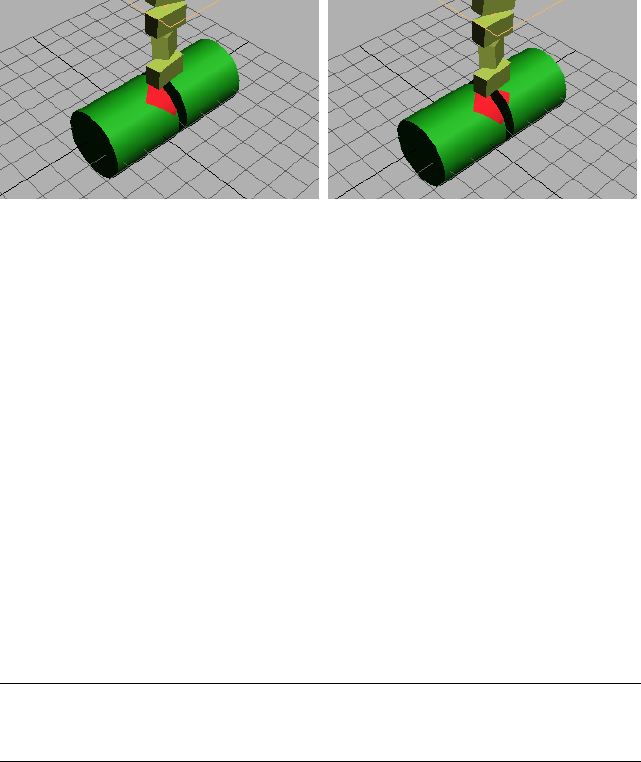
Box Height Sets the height of the box used with the Box Intersection method.
Available only with Box Intersection. Default=10.0.
Allow Multiple Elements When on, particles can leave marks on all parts of
contact objects that contain multiple elements. When off, a particle marks
only the first element it collides with. Available only with Box Intersection.
Default=off.
Particles falling onto a two-element cylinder
Left: Allow Multiple Elements is off; Right: Allow Multiple Elements is on.
Continuous Update When on, the shape of the mark is recalculated at each
frame, according to the current positions of the particle and the contact surface.
This option can consume a great deal of CPU time. Available only with Box
Intersection.
Generate Mapping Coords. Allows correct application of the shape mark
when using a mapped material. Default=on.
If you're not using a mapped material, you can save memory by turning this
off.
Pivot Offset % Shifts the position of the shape mark along its length
dimension with respect to the pivot of the impacting particle. Default=0.0.
Range=-50.0 to 50.0.
By default, the center of the mark's length dimension coincides with the point
where the particle's pivot strikes the contact object. This setting lets you offset
the mark's position to anywhere along its length.
NOTE The width dimension and the Box Intersection's height dimension are
always centered at the intersection of the particle pivot and the contact object's
surface.
Surface Offset Specifies the distance of the shape mark above the contact
object's surface. Default=0.001.
2838 | Chapter 12 Space Warps and Particle Systems
The mark is slightly elevated above the contact geometry to achieve the visual
effect of the mark spot overlapping the contact geometry. This parameter is
not animatable.
Offset Variation Specifies the maximum extent of a random variation in the
actual surface offset among particles. Default=0.0.
Adjusting this value can help to alleviate rendering artifacts with overlapping
marks.
Vertex Jitter Specifies the maximum extent of a random variation in the
positions of vertices of marks created using the Box Intersection method.
Available only with the Box Intersection method. Default=0.0.
Adjusting this value can help to alleviate rendering artifacts with overlapping
marks.
Uniqueness group
The Uniqueness setting enables changing the randomization of the size/width
variation.
Seed Specifies a randomization value.
New Calculates a new seed using a randomization formula.
Materials and Mapping in Particle View
Particle Flow provides three operators for applying materials to particles. To
give the same appearance to all particles throughout an event, use Material
Static Operator on page 2841 . If you're using a compound material such as
Multi/Sub-Object on page 5558 , you can assign different sub-materials to
different particles with the Material Frequency operator on page 2844 . And to
assign materials that change in appearance over time, use the Material
Dynamic operator on page 2846 .
Related to this is the Mapping operator on page 2853 , which lets you give the
same mapping coordinates to the entire surface of each particle in an event,
thus using a single pixel from a material to color the particles. By animating
the mapping coordinates, you can cause the particles to change color over
time. This is particularly effective with a gradient material.
The Bitmap map on page 5633 , used in conjunction with Material Dynamic,
lets you assign different frames from an image sequence to particles based on
the particle age, among other effects.
Particle Flow | 2839
Following are some items to keep in mind when using materials with Particle
Flow:
■A material is a static property of an event. It does not travel along with
the particles from one event to the next. A particle's material ID does, but
its material does not. If you want particles always to use the same material,
define the material in the global event on page 7801 with a Material operator
or a Shape Instance operator on page 2825 . Otherwise, you need to define
it in each local event.
■The primitive particle shapes available with the Shape operator on page
2821 do not have mapping coordinates. The Mapping operator on page 2853
applies the same mapping coordinates to each particle's entire surface, so
it's not suitable in this situation. If you want to apply image-based materials
to particles, use Shape Instance on page 2825 instead.
■If you use a Material operator with Shape Instance on page 2825 , be sure
to apply mapping coordinates to the reference object(s) on page 7910 . You
can do this by making sure the object's Generate Mapping Coords option
is on (if available), or applying a UVW Map modifier on page 1849 or
Unwrap UVW modifier on page 1769 . If you don't apply mapping
coordinates, the system generates a Missing Map Coordinates warning
when you render the scene.
■If you use an object with a material already applied as a reference object
on page 7910 for instanced particles, you don't need a Material operator in
the same event. However, the material appears only in the event containing
the Shape Instance operator on page 2825 ; it does not persist from event
to event.
■If you use the Cache operator on page 2856 with Update set to Always,
toggling the Material Editor > Show Map In Viewport switch causes Particle
Flow to recalculate the cache.
■You can drag a material from the Material Editor to a Particle Flow source
icon, but the material will not have any effect on the system. You must
use a Material operator or Shape Instance to apply materials to particles
in Particle Flow.
■Once you've assigned a material to a Material operator, the material shows
up in the Material Editor as “hot”; that is, triangles appear in the corners
of its sample slot. However, because of the nature of the Particle Flow data
structure, the Material Editor functions Select By Material and Get Material
> Browse From Selected do not work correctly with Particle Flow systems.
You can, however, use Get Material > Browse From Scene.
2840 | Chapter 12 Space Warps and Particle Systems
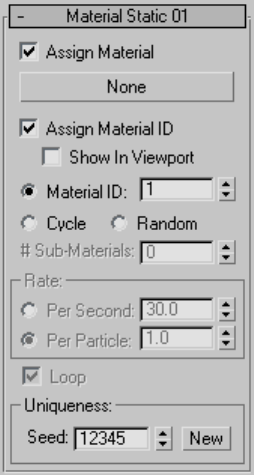
Material Static Operator
Particle View on page 2730 > Click Material Static in an event or add a Material
Static operator to the particle system and then select it.
The Material Static operator lets you give particles material IDs that remain
constant throughout the event. It also lets you assign a material to each particle
based on its material ID. The operator can assign the same material ID to all
particles, or different IDs to successive particles on a cyclical or random basis.
The most common usage of this latter capability is with a Multi/Sub-Object
material, for applying a different material to each particle.
See also:
■Materials and Mapping in Particle View on page 2839
■Material Frequency Operator on page 2844
■Material Dynamic Operator on page 2846
Interface
Particle Flow | 2841

The user interface appears in the parameters panel, on the right side of the
Particle View dialog.
Assign Material When on, the operator assigns a material to the particles.
Default=on.
[button] Use this button to assign a material to the operator. Click the button
and then use the Material/Map Browser to choose the material. Alternatively,
drag the material from a Material Editor sample slot to the button. After you
assign a material to the operator, its name appears on the button.
Assign Material ID When on, the operator defines a material ID number for
each particle. Default=off.
Show In Viewport When on, the material is shown applied to the particles
in the viewports.
Assignment Method
The Material Static operator gives you a choice of three different methods for
assigning Material IDs to particles:
Material ID Assigns the same material ID to all particles. Use the numeric
field to set the ID value.
Cycle Assigns each particle a material ID in the range 1 to N, where N=#
Sub-Materials, in increasing sequential order. The first ID assigned is 1, then
2, then ..., then N, then 1 again, and so on.
Random Assigns each particle a random material ID in the range 1 to N,
where N=# Sub-Materials.
# Sub-Materials The highest ID number assigned to particles using the Cycle
or Random option.
In general, set this to the same number of sub-materials in the Multi/Sub-Object
material. If you set it to a smaller number, the operator will use only that
many sub-materials, starting with the first and counting upward.
NOTE The software automatically sets this value to the number of sub-materials
in the material, once only , the first time you apply the material to the operator.
Any subsequent changes in the material itself, or applying a different material to
the operator, will not change or update the setting.
Rate group
These settings let you choose the basis on which the operator changes material
ID assignments, and specify the rate of change.
2842 | Chapter 12 Space Warps and Particle Systems
Per Second Sets the number of times per second that the assigned material
ID is incremented. If this value is the same as the rate at which particles enter
the event, then one ID is assigned per particle. If it's lower, then multiple
particles are given the same ID, or if it's higher, then the software increments
the assigned ID faster than 1 per particle.
For instance, if particles enter the event at intervals of 1/60 of a second, and
Per Second=30, then each pair of particles will be assigned the same ID. Or if
particles enter the event at intervals of 1/15 of a second, and Per Second=30,
then the ID is incremented (or changed randomly) twice per particle.
Per Particle Sets the number of particles that must appear before material
ID assignment changes. For example, If you set Per Particle=3, the material
ID changes every three particles.
If you set Per Particle to a number less than 1.0, the software then moves
through the sub-material list more rapidly than one (or more) particle per ID.
That is, the software divides this value into 1.0, and adds the result to the
current material ID to obtain the next one. For example, with eight
sub-materials, if you set Per Particle=0.33, and use the Cycle option, the
following series of IDs will result: 1, 4, 7, 2, 5, 8, 3, 6, 1, ... In general, this
option is useful only with the Cycle option.
Loop When on, and the last ID has been assigned, the software loops back
around to the first ID and continues the cycle. When off, the software assigns
the last cycle ID to all subsequent particles. Available only with the Cycle
assignment method. Default=on.
For example, say you want the first eight particles that enter the event to use
different materials, and all subsequent particles to use a ninth material. To do
so, you would create a nine-sub-material Multi/Sub-Object material and assign
it to the Material Static operator. Turn on Assign Material ID, choose the Cycle
assignment method, and set # Sub-Materials=9. For Rate, use the default settings
of Per Particle and 1.0. Lastly, turn off Loop.
Uniqueness group
The Uniqueness setting varies the sequence of assigned IDs with the Random
option.
Seed Specifies a randomization value.
New Calculates a new seed using a randomization formula.
Particle Flow | 2843
Material Frequency Operator
Particle View on page 2730 > Click Material Frequency in an event or add a
Material Frequency operator to the particle system and then select it.
The Material Frequency operator lets you assign a material to an event, and
specify the relative frequency with which each sub-material appears on the
particles. Typically, the material is a Multi/Sub-Object or other compound
material, and you specify the frequency by setting a percentage for each of
up to 10 different sub-materials (or material ID). The software assigns IDs to
particles in a random sequence, based on these percentages. You can also use
other materials that use sub-materials, such as Double Sided and Top/Bottom.
See also:
■Materials and Mapping in Particle View on page 2839
■Material Static Operator on page 2841
■Material Dynamic Operator on page 2846
2844 | Chapter 12 Space Warps and Particle Systems
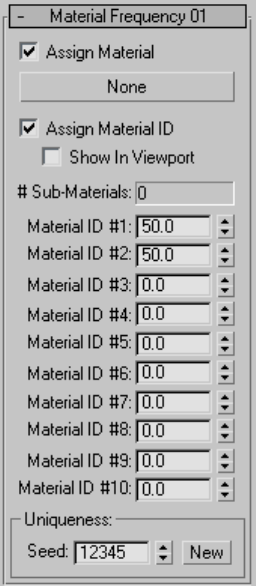
Interface
The user interface appears in the parameters panel, on the right side of the
Particle View dialog.
Assign Material When on, the operator assigns a material to the particles.
Default=on.
[button] Use this button to assign a material to the operator. Click the button
and then use the Material/Map Browser to choose the material. Alternatively,
drag the material from a Material Editor sample slot to the button. After you
assign a material to the operator, its name appears on the button.
Assign Material ID When on, the operator defines a material ID number for
each particle, and enables the remaining parameters. Default=on.
In general, this should remain on. Particle Flow uses the material ID with
compound materials to know which sub-material to assign to a particle.
Particle Flow | 2845
Show In Viewport When on, the material is shown applied to the particles
in the viewports.
# Sub-Materials Displays the number of sub-materials in the assigned
material.
Material ID #1–10 Specifies the relative likelihood of particles to be assigned
the corresponding material ID. Assign values for all IDs, or sub-materials, in
the material that you want to have applied to the particles. So, for example,
with a Multi/Sub-Object material containing five sub-materials, you'd set
values for Material IDs #1-5.
This value is not absolute, but relative to the other settings. To follow the
previous example, if you wanted all five materials to appear with equal
frequency, you'd set the same non-zero value for Material IDs #1-5; the actual
value wouldn't matter. On the other hand, if you wanted the materials to
appear with decreasing frequency, you'd set the lower Material ID settings to
relatively higher values; say 100, 80, 50, 33, and 10. In this case, each particle
would twice as likely to be assigned material ID 1 as it would material ID 3,
and one-tenth as likely to be assigned ID 5 as it would ID 1.
The actual sequence of material ID assignments is random, and can be varied
by changing the Uniqueness Seed setting.
Uniqueness group
The Uniqueness setting varies the random sequence of assigned IDs.
Seed Specifies a randomization value.
New Calculates a new seed using a randomization formula.
Material Dynamic Operator
Particle View on page 2730 > Click Material Dynamic in an event or add a
Material Dynamic operator to the particle system and then select it.
The Material Dynamic operator lets you give particles material IDs that can
vary during the event. It also lets you assign a different material to each particle
based on its material ID. When used with an animated texture on page 7711 ,
this lets you assign a different frame or map to each particle based on its total
age or the amount of time it has spent in the current event. In this context,
one example of an animated texture is a material that uses a multi-frame
bitmap, such as an AVI file, as the Diffuse Bitmap map on page 5633 . Other
examples of animated textures are materials that use the Particle Age map on
2846 | Chapter 12 Space Warps and Particle Systems
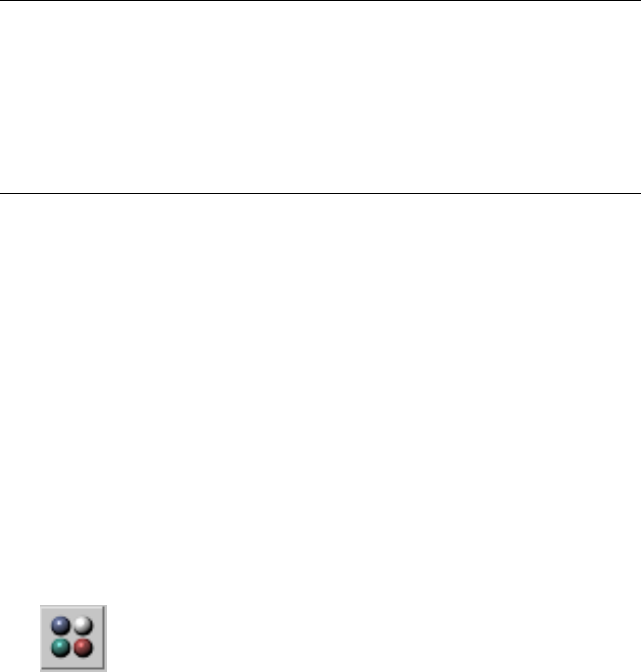
page 5727 or the Particle MBlur map on page 5729 . Alternatively, you can use
different sub-materials from a compound material such as Multi/Sub-Object.
NOTE When using Object Motion Blur, if an event contains a Material Dynamic
operator that uses a material with a Particle Age/MBlur/Bitmap map, the event
should not also contain a Delete operator, or a Spawn or Collision Spawn test.
Also, the event should not contain any tests that are wired to another event. The
only exception to this is the Age Test operator when set to Absolute Time without
any variation; that is, all particles leave the event at the same time. This applies to
the use of Object Motion Blur only; there are no restrictions with Image Motion
Blur.
See also:
■Materials and Mapping in Particle View on page 2839
■Material Static Operator on page 2841
■Material Frequency Operator on page 2844
Procedures
Example: To assign animation frames to particles based on age:
1Prepare a file to be used as the animated bitmap. This can be a
multiple-frame format such as AVI, or an image file list (IFL file) that
points to a sequence of still images. With the latter, you can use images
in a format such as Targa that contain predefined alpha channels to
specify particle opacity selectively.
2 Open the Material Editor, and assign a Bitmap map as the Diffuse
map.
3Use the Select Bitmap Image File dialog to assign the file from step 1 as
the bitmap. This dialog appears automatically when you first assign a
Bitmap map; alternatively, click the Bitmap button on the map's Bitmap
Parameters rollout.
4On the map's Time rollout, turn on Sync Frames To Particle Age.
5If you want to use the image background or alpha channel to define
transparency, on the Maps rollout, copy this map to the Opacity slot,
and set the parameters accordingly.
Particle Flow | 2847

6 At the material level, turn on Show Map In Viewport.
7Add a camera to the scene and set it up as desired. Activate the Perspective
viewport and press the C key to set the viewport to show the camera view.
8Create a default Particle Flow system.
9Open Particle View.
10 Replace the Shape operator with a Shape Facing operator.
Using this operator makes it easier to see the animation.
11 Click the Shape Facing operator, and in its rollout, click the Look At
Camera/Object button, and then select the camera.
12 In the Size/Width group, increase In World Space > Units to about 15.
13 Add a Material Dynamic operator to Event 01, and assign it the material
from the beginning of this procedure.
14 Turn on Show In Viewport.
15 In the Animated Texture group, make sure Same As Particle ID is chosen,
and turn on Reset Particle Age.
Always choose Same As Particle ID with an animated texture, and one of
the Sub-Material Rotoscoping options when using a compound material.
Turning on Reset Particle Age causes the software to set particles to age
0 as they enter the event. In this example, the particles are born in the
event, so technically it's not necessary to turn on Reset Particle Age.
However, it's a good habit to get into to ensure that the animation always
plays from the first frame.
16 Play the animation.
In the viewport, the bitmap animation advances as the particles move,
but all the particles show the same frame, regardless of age. This is
anomalous behavior related to the limitations of viewport interactivity.
The particles render correctly, however.
17 Render the animation.
As each particle is born, it begins displaying the animation from the first
frame. At each frame, each particle's age is incremented, and it displays
the next frame from the applied map.
2848 | Chapter 12 Space Warps and Particle Systems
Example: To use the Particle Age map:
The Particle Age map on page 5727 applies up to three different colors or maps
to particles throughout their life span, gradually changing from one to the
next as the particles age. This effect can be used, for example for sparks flying
from a fire: At first they're yellow; then, as they cool down, they turn red, and
finally they become gray ashes. In order for Particle Age to know how far a
particle has progressed through its life span, the particle has to be given a
finite life. You do this using the Delete operator on page 2768 .
1Start or reset the program, and add a Particle Flow system.
2Open Particle View and the Material Editor. Position them side by side.
3In Particle View, add a Material Dynamic operator and a Delete operator
to Event 01.
For Particle Age to work, the Delete operator must be in the same event
as the Material Dynamic operator. Alternatively, you can add the Delete
operator to the global event on page 7801 so that it affects every event.
4Click the Delete operator, and in the parameters panel, choose By Particle
Age, and set Life Span=100 and Variation=0.
This gives each particle a life span of 3 1/3 seconds.
5Click the Material Dynamic operator.
6In the Material Editor, assign a Particle Age map as the Diffuse map. On
the Particle Age Parameters rollout, set three different colors, such as red,
green, and blue. Also change the Age percentage values as necessary. For
example, if you want each particle to show the second color a third of
the way through its life instead of halfway, change Age #2 to 33.
7Drag the active material from its sample slot to the material button on
the Material Dynamic parameters rollout in Particle View. When the
Instance (Copy) dialog appears, click OK to accept the default choice:
Instance.
8In the Material Dynamic parameters, make sure Assign Material ID is on.
If it isn't, the particles all change color at the same time.
There's no need to turn on Show In Viewport; the Particle Age map doesn't
appear in the viewports.
9Render the animation, or a few representative frames.
As each particle falls, it gradually changes color, with the oldest particles
changing first.
Particle Flow | 2849
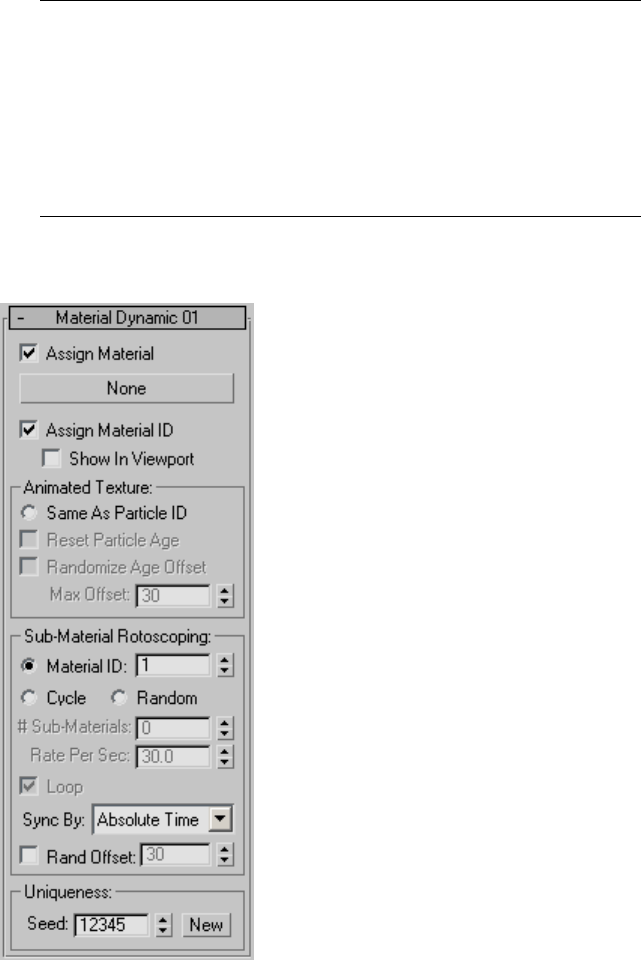
TIP You needn't actually delete the particles to use this method. There are
several ways to avoid this. You could set Life Span to a higher number than
the length of the animation, and then, in the Particle Age map parameters,
lower the Age #2 and Age #3 settings. Or, if you're using a local Delete
operator, you could use an Age test on page 2879 to move the particles into
another event just before they're scheduled to be deleted. In that case, to
avoid an abrupt color change, you might want to add to subsequent events
a Material Static operator on page 2841 with a material that uses the same
final color or map as the Particle Age map.
Interface
2850 | Chapter 12 Space Warps and Particle Systems

The user interface appears in the parameters panel, on the right side of the
Particle View dialog.
Assign Material When on, the operator assigns the specified material (see
next parameter) to the particles. Default=on.
[button] Use this button to assign a material to the operator. Click the button
and then use the Material/Map Browser to choose the material. Alternatively,
drag the material from a Material Editor sample slot to the button.
After you assign a material to the operator, its name appears on the button.
Assign Material ID When on, the operator defines a material ID number for
each particle. Default=on.
In general, this should remain on. Particle Flow uses the material ID with the
Particle Age map to find the particle's other properties, including its life span
and current age. And it uses the material ID with compound materials to know
which sub-material to assign to a particle.
Show In Viewport When on, the material is shown applied to the particles
in the viewports when the particles are displayed as geometry.
Assignment Method
The Material Dynamic operator lets you assign Material IDs to particles in
several different ways, depending on whether you're using an animated texture
or a compound material. Default=Same As Particle ID.
Animated Texture group
Same As Particle ID Assigns the same material ID to a particle as its particle
ID. Choose this when using a material containing an animated texture, such
as a Bitmap, Particle Age, or Particle MBlur map.
NOTE Particle Flow assigns Particle IDs consecutively to particles at birth, starting
with 0. Although the highest possible Particle ID is over 2,000,000,000, the highest
possible material ID is 65535. Thereafter, the numbering sequence starts again
at 0. Thus, when using a Particle Age map in a material assigned to the Material
Dynamic operator, for best results, use a total of 65,536 particles or fewer.
Reset Particle Age When on, sets each particle's age to 0 when it enters the
event.
When using an animated material with a Bitmap map, turn this on to ensure
that the animation always plays from the first frame.
Particle Flow | 2851

Randomize Age Offset When on, the software varies the difference between
the particle age and the starting material ID at random. The maximum
difference is determined by the Max Offset parameter.
Max Offset The maximum number of frames by which the software can
randomly vary particle age.
Sub-Material Rotoscoping group
These settings let you choose the basis on which the operator changes material
ID assignments when using a compound material such as Multi/Sub-Object,
and specify the rate of change.
Material ID Assigns the same material ID to all particles. Use the numeric
field to set the ID value.
Cycle Assigns each particle a material ID in the range 1 to N, where N=#
Sub-Materials, in increasing sequential order. The first ID assigned is 1, then
2, continuing to increment each by 1 until N; then 1 again, and so on.
Random Assigns each particle a random material ID in the range 1 to N,
where N=# Sub-Materials.
# Sub-Materials The highest ID number assigned to particles using the Cycle
or Random option.
In general, set this to the same number of sub-materials in the Multi/Sub-Object
material. If you set it to a smaller number, the operator will use only that
many sub-materials, starting with the first and counting upward.
NOTE The software automatically sets this value to the number of sub-materials
in the material, once only , the first time you apply the material to the operator.
Any subsequent changes in the material itself, or applying a different material to
the operator, will not change or update the setting.
Rate Per Sec(ond) Sets the number of times per second that the assigned
material ID is incremented. If this value is the same as the rate at which
particles enter the event, then one ID is assigned per particle. If it's lower, then
multiple particles are given the same ID, or if it's higher, then the software
increments the assigned ID faster than 1 per particle.
For instance, if particles enter the event at intervals of 1/60 of a second, and
Per Second=30, then each pair of particles will be assigned the same ID. Or if
particles enter the event at intervals of 1/15 of a second, and Per Second=30,
then the ID is incremented (or changed randomly) twice per particle.
2852 | Chapter 12 Space Warps and Particle Systems
Loop When on, and the last ID has been assigned, the software loops back
around to the first ID and continues the cycle. When off, the software assigns
the last cycle ID to all subsequent particles. Available only with the Cycle
assignment method. Default=off.
For example, say you want the first eight particles that enter the event to use
different materials, and all subsequent particles to use a ninth material. To do
so, you would create a nine-sub-material Multi/Sub-Object material and assign
it to the Material Dynamic operator. Choose the Cycle assignment method,
and set # Sub-Materials=9. Set the Rate Per Sec value to the rate at which
particles enter the event. Lastly, turn off Loop.
Sync By Choose the time frame for applying animated parameters. Available
only with the Material ID and Cycle options.
■Absolute Time Any keys set for parameters are applied at the actual frames
for which they're set.
■Particle Age Any keys set for parameters are applied at the corresponding
frames of each particle's existence.
■Event Duration Any keys set for parameters are applied to each particle
starting when it first enters the event.
Rand Offset When on, the software varies the difference between the particle
age and the assigned material ID at random. The maximum difference is
determined by the numeric parameter. Available only with the Material ID
and Cycle options.
Uniqueness group
The Uniqueness setting varies the sequence of assigned IDs with the Random
option, and the offset with the Randomize Age Offset option.
Seed Specifies a randomization value.
New Calculates a new seed using a randomization formula.
Mapping Operator
Particle View on page 2730 > Click Mapping in an event or add a Mapping
operator to the particle system and then select it.
The Mapping operator lets you assign a constant UVW mapping to the entire
surface of the particles. It works in conjunction with a map specified in a
Particle Flow | 2853

material operator in the current event. By animating the mapping coordinates,
you can vary the location on the material map from which the particle color
is taken, thus changing the particle color in a predictable way over time.
The Mapping operator was designed primarily to be used with gradient maps,
although you can use it with any map you like. The procedure below describes
a recommended method for using the Mapping operator.
See also:
■Material Static Operator on page 2841
■Material Frequency Operator on page 2844
■Material Dynamic Operator on page 2846
Procedures
Example: To animate particle coloring using the Mapping operator:
1 Open the Material Editor, and create a material that uses Gradient
Ramp as the Diffuse map.
2On the map's Gradient Ramp Parameters rollout, make sure Gradient
Type is set to Linear.
3Create a colorful gradient. The Mapping operator uses the colors in
left-to-right order as the U value increases from 0.0 to 1.0.
4Add a Particle Flow Source object to the scene.
5Open Particle View.
6In Event 01, click the Speed operator and set Speed to 100.
7In Event 01, click Display and set Type to Geometry.
8Add a Material Static operator to Event 01, and then click the operator
in the event.
9Drag the material you created from its Material Editor sample slot to the
button (labeled “None”) on the Material Static parameters rollout in
Particle View.
10 Add a Mapping operator to Event 01, and then click the operator in the
event.
2854 | Chapter 12 Space Warps and Particle Systems
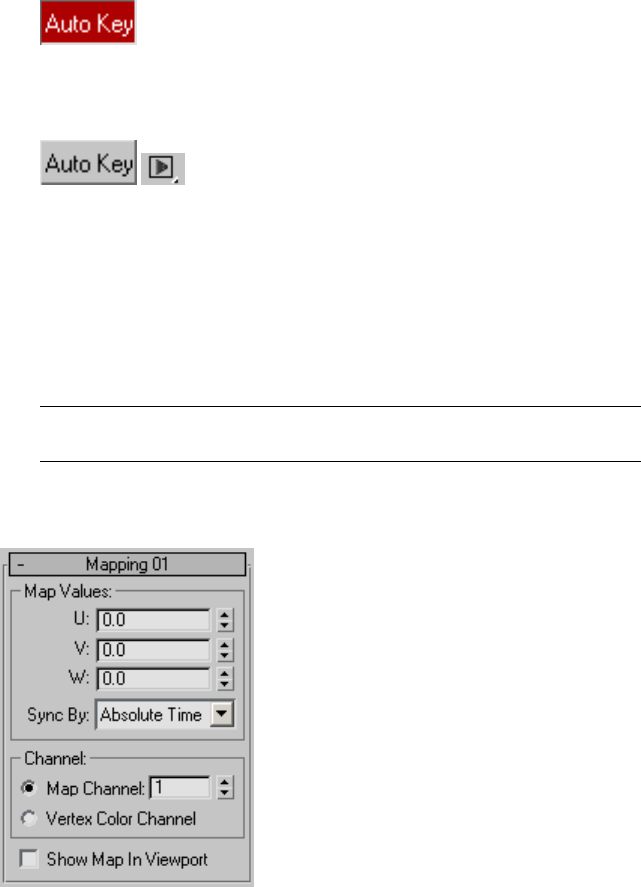
11 On the Mapping rollout in Particle View, turn on Show Map In Viewport.
12 Go to frame 100 and turn on Auto Key.
13 On the Mapping rollout in Particle View, set Map Values > U=1.0.
14 For Sync By, choose Particle Age.
15 Turn off Auto Key, and click Play Animation.
As each particle is born and falls, its U mapping coordinate gradually
changes from 0.0 to 1.0, while its color changes to match the
corresponding position across the Gradient Ramp map.
To vary the effect, try changing the Gradient Type setting, and animate
the V and W values as well. Or, for more sophisticated effects, assign
animation controllers such as Noise Float to the Mapping coordinate
values, or wire them to other changing parameters in the scene
(Animation menu > Wire Parameters > Parameter Wire Dialog).
TIP In the Material Editor, it's easier to see the result of the Gradient Type
choice if you set Sample Type to Cube.
Interface
The user interface appears in the parameters panel, on the right side of the
Particle View dialog.
Particle Flow | 2855
Map Values group
U/V/W Set the coordinates on the map from which the particle color is
taken. One pixel from this location is used to color the entire particle.
In general, U and V represent the horizontal and vertical dimensions,
respectively, beginning at the upper-left corner of the map, and W is useful
only with three-dimensional maps, in which context it specifies depth.
Sync By Choose the time frame for applying animated parameters. For further
information, see Animation Offset Keying group on page 2790 .
■Absolute Time Any keys set for parameters are applied at the actual frames
for which they're set.
■Particle Age Any keys set for parameters are applied at the corresponding
frames of each particle's existence.
■Event Duration Any keys set for parameters are applied to each particle
starting when it first enters the event.
Channel group
The Channel setting determines whether the mapping is applied to a map
channel or to a vertex color channel.
Map Channel The mapping is applied to the specified map channel.
Vertex Color Channel The mapping is applied to the particles' vertex color
channel.
Show Map In Viewport The map coloring is visible in the viewports.
Additional Operators
Cache Operator
Particle View on page 2730 > Click Cache in an event or add a Cache operator
to the particle system and then select it.
The Cache operator records and stores particle states to memory. When it's
in effect, the first time you play or go to a frame, the particle motion up to
and including the frame is calculated and recorded in the cache. Thereafter,
2856 | Chapter 12 Space Warps and Particle Systems
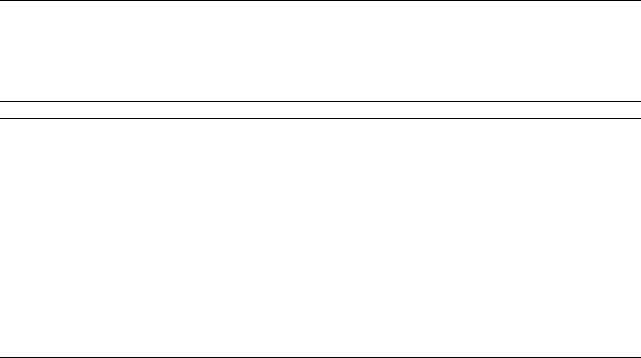
playing the frame or any previous frames uses the data in the cache, rather
than recalculating the particle action. This is particularly useful with large or
complex particle systems, where playback, and particularly backtracking, are
slow because of the large amount of processing required. With caching on,
the particle system needs to be calculated only once for each frame, and
thereafter playback and moving among frames is significantly faster.
To cache an entire flow, add a Cache operator to the global event. To cache
an individual local event, add a Cache operator to it.
To determine how best to implement caching in your particle system, turn
on Particle View > Track Update > Update Progress, and then play the
animation or go to a frame relatively distant from the current frame. Observe
the particle diagram, and watch for events with actions that highlight longer
than a fraction of a second, or events with more activity than the rest. Any
such events could benefit from caching.
NOTE Use no more than one Cache operator per event, unless you’re using two:
one set up for viewports, and the other for rendering. Similarly, don’t use global
and local Cache operators in the same flow, unless one is set up for viewports,
and the other for rendering.
TIP When using real-time playback, if playback isn't fast enough, you can use
the Cache operator to speed it up. For best results, set the Viewport integration
step to the same value as the real-time playback speed, and set cache sampling
to Integration Step. For example, if the real-time playback speed is set to 1/4x,
then the Viewport Integration Step for viewport should be also set to 1/4 Frame,
and the Cache operator Sampling parameter should be set to Integration step.
Thus, because real-time playback is showing four times as many frames per second,
and the Cache operator has stored four times as many frames per second, the two
are synchronized. If the real-time playback speed is set to 2x or 4x, set the Viewport
Integration Step to Frame.
Procedures
Example: To use the Cache operator:
1Start or reset the software, and then add a Particle Flow system.
2Open Particle View.
3In Particle View, go to Options menu > Track Update and turn on Update
Progress.
This lets you monitor calculation of the particle system by highlighting
actions in Particle View as the system executes them.
Particle Flow | 2857
4In Particle View, Add a Keep Apart operator on page 2815 to Event 01.
Keep Apart is a fairly calculation-intensive operator.
5Go to frame 100 by clicking the right end of the time slider track.
There is a delay as the system calculates all particle motion between
frames 0 and 100. This is necessary because Particle Flow is a
history-dependent system. At the same time, the actions in the system
highlight briefly in Particle View as they're executed at each frame.
6Go to frame 50 by clicking the center of the time slider track.
There is a another delay as the system calculates all particle motion
between frames 0 and 50.
7In Particle View, drag a Cache operator from the depot to Event 01. Insert
it anywhere in the event.
When you release the mouse button, there is a delay as the Cache operator
automatically caches particle motion from the start of the animation to
the current frame. Meanwhile, each action highlights briefly at each
frame.
8Go to frame 20 or so.
The only operators that highlight are Cache (very fast) and Display; there
is no delay for calculation. All frames between 0 and 50 have been cached.
9Go to frame 100.
The delay this time is a result of caching particle motion for frames 50
to 100.
10 Jump to different frames, and drag the time slider.
All particle motion is now cached, so no delays occur. But if you change
a setting's value, the Cache operator automatically recalculates and stores
the particle motion.
11 Go to frame 100, and then, in Particle View, click the Keep Apart operator
and use the keyboard to change the Falloff Zone value to 8.0.
By default, the Cache operator automatically updates the cache when
you change any parameters it stores. Thus, when you change the Falloff
Zone value at frame 100, it recalculates and recaches the entire animation.
Next, you'll briefly explore how manual caching works.
12 Click the Cache operator and set Update to Manually.
The Cache operator no longer updates the stored data automatically when
you change a parameter.
2858 | Chapter 12 Space Warps and Particle Systems
13 Click the Keep Apart operator, change the Falloff Zone value to 9.0, and
then drag the time slider.
There is no delay, because the animation is still playing back from the
cached data. However, the cached data is now invalid, because you
changed a parameter in the particle system.
14 Click the Cache operator, and in the Manual Update group, click Update.
The software closes Particle View, updates the cache for the active
segment, and then reopens Particle View. The cached data is now accurate.
Other manual update options let you update the cache for the entire
animation or a custom frame range.
As you can see, the Cache operator is quite powerful. When present and
active, by default it overrides recalculation of the particle system, except
when you change any action parameters, whereupon it automatically
updates the cached data. Used appropriately, it can save a good deal of
time in setting up and testing particle systems.
Particle Flow | 2859
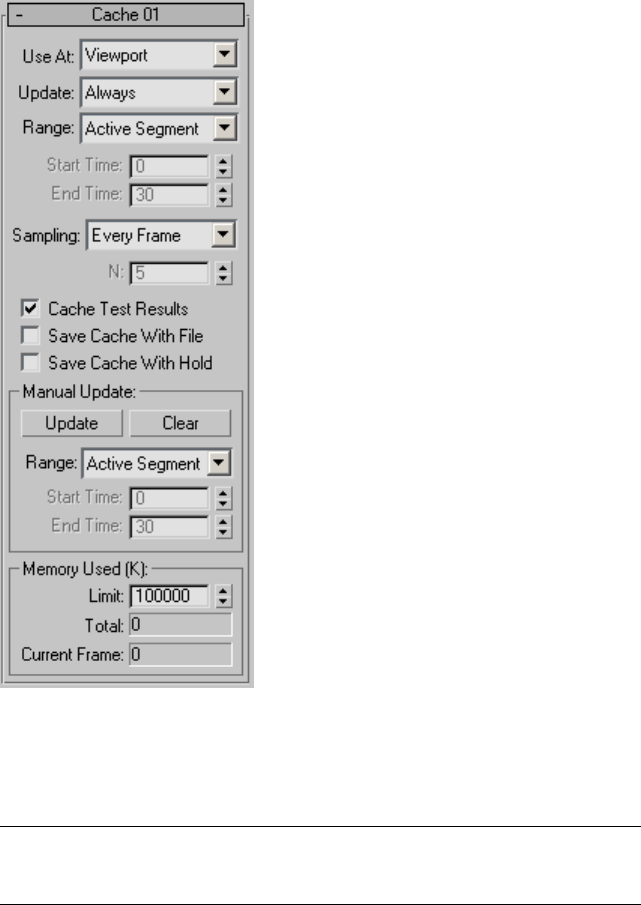
Interface
The user interface appears in the parameters panel, on the right side of the
Particle View dialog.
Use At Caches particle motion when playing back in the viewports, or at
render time, or both. Default=Viewport.
IMPORTANT Choose the Viewport/Render option only when using the same
number of particles in the viewports and for rendering (see Quantity Multiplier
group on page 2752 ). Otherwise, unpredictable results can occur.
2860 | Chapter 12 Space Warps and Particle Systems
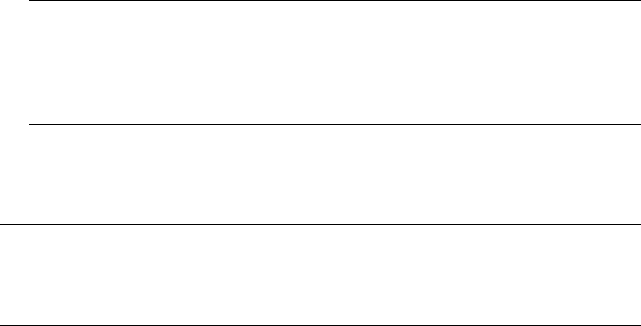
Update If you change a parameter in the particle system, the cached data
might become invalid. This setting determines whether Particle Flow should
update the cache automatically, or let you do it manually. Default=Always.
■Always Changing any parameter under the Cache operator's purview
causes it automatically to update stored data from the start of the current
range (see next parameter) to the current frame.
■Manually Updating occurs only when you click the Update button, or
clear the cache and then move to a different frame.
Range Sets the frame range within which the Cache operator operates.
Default=Active Segment.
■Complete The software caches the entire animation.
■Active Segment The software caches only frames in the active segment,
as defined by the Start Time and End Time settings on the Time
Configuration dialog. This is the frame range shown on the track bar. You
can also change the active segment by holding down Alt and Ctrl and
dragging the track bar with the left, middle, or right mouse button.
■Custom The software caches only frames in the custom range, as defined
by the Cache operator's Start Time and End Time settings (see following).
NOTE If you cache only part of the animation, Particle Flow calculates particle
behavior in subsequent, non-cached frames using the cached data. For example,
if you cache frames 0 to 50, and then jump to frame 60, Particle flow will
calculate frame 51 based on the cached data, and frames 52 to 60 based on
each previous frame.
Start/End Time The first and last frames of the range considered for caching
when Range=Custom (see above). Default=0, 30.
NOTE The frame range time frame is in absolute time; that is, in terms of the
entire animation. If you use a Cache operator locally, and specify a frame range
during which no particles are present in the event, Particle Flow won't use the
cache.
Sampling Determines how often the Cache operator samples and caches the
animation. Default=Every Frame.
■Every Frame The software caches animation data once per frame.
Particle Flow | 2861
■Integration Step The software caches animation data at each integration
step, using the Integration Step setting as specified in the Use At setting
(see above). If Use At is set to Viewport/Render, it uses lower of the two
Integration Step values. For example, if Viewport is set to Half Frame, and
Render to 1/8 Frame, the sampling rate would be eight per frame.
■Every Nth Frame The software caches animation data at frame intervals
specified by the N value, below.
NDetermines the frame interval for caching when Sampling (above) is set
to Every Nth Frame. Default=5.
For example, with N set to the default value of 5, the cache stores animation
data for every fifth frame.
Cache Test Results When caching particle data, this caches the results of
test actions as well. Default=on.
This is important if Cache is used as a local operator, and the next event
doesn’t have a Cache operator. For the next event to work properly, it should
receive particles from the current event. Those particles result from the activity
of a test action. The Cache operator can record the test activity to play it back
later.
If the Cache operator is used as a global operator, there is no need to cache
the test results. This is because the system has cache data for every event, and
is able to jump to an arbitrary frame without the need for test results.
Save Cache with File When on, the software Includes the cached data with
scenes that you save to disk. This can significantly increase the size of saved
files, but saves the time of recalculating the particle motion upon reloading
the file. Default=off.
Normally, the cache data is saved only in disk files that you create with the
Save or Save As commands. You can also instruct the software to include
cached data with other types of files using the two following options.
Save Cache with Hold Saves cached data in the Hold file, created with Edit
menu > Hold. Default=off.
Manual Update group
These controls let you update or clear the cache manually within a frame
range, or clear the entire cache.
2862 | Chapter 12 Space Warps and Particle Systems
Update Calculates particle motion within the current range (defined below)
and stores it in the cache, replacing any existing cached data. Available only
when Range is set to Active Segment or Custom.
During the update, the software temporarily closes Particle View and displays
a Cache Update Progress bar, while moving the time slider through the cached
range. At the same time, by default, the animation plays in the viewports. To
prevent this, and speed calculation, turn off Update Viewports.
If the cache runs out of memory during a manual update, Particle Flow halts
the update operation and displays an alert. Click OK to continue, and then,
if possible, increase the Limit value before updating the cache again.
Clear Deletes any cached data.
After you clear the cache buffer, if you go to a different frame or change any
action parameters, the software automatically caches particle motion even if
Update is set to Manually.
Range Sets the frame range within which the Cache operator recalculates
data when you click Update. Default=Active Segment.
■Complete The software clears the cache for entire animation. Choosing
Complete makes the Update button unavailable; this option is for clearing
the cache only.
To update the entire animation, set the active segment or the custom range
to encompass all frames, and then use the corresponding choice and click
Update.
■Active Segment The software updates the cache only for frames in the
active segment, as defined by the Start Time and End Time settings on the
Time Configuration dialog. This is the frame range shown on the track
bar. You can also change the active segment by holding down Alt+Ctrl and
dragging the track bar with the left, middle, or right mouse button.
■Custom The software updates the cache only for only frames in the
custom range, as defined by the Start Time and End Time settings (see
following).
Start/End Time The first and last frames of the range that's updated when
Range=Custom (see above). Defaults=0, 30.
Update Viewports When on, the animation plays in the viewports during
manual updating of the cache. Turn this off to disable playing the animation
in the viewports during manual caching; this can speed up the caching process,
especially with large or complex particle systems. Default=on.
Particle Flow | 2863

Memory Used (K) group
The Cache operator stores data in system memory; you can specify an upper
limit for the amount of memory it uses. If the Limit setting and the amount
of cached data exceeds the available free memory, the computer system might
use virtual (hard disk-based) memory instead, which slows down the caching.
If Particle Flow fills the cache, any remaining frames are calculated on the fly.
This group also lets you monitor the amount of memory used for caching
data.
Limit The maximum amount of system memory used to cache particle data,
in kilobytes. Default=100,000, or 97.6 MB.
Total The amount of memory currently used by the cached data, in kilobytes.
Read-only.
NOTE Even animation frames with no particles will probably consume a certain
amount of cache memory. The reason for this is that the cache also stores states
for randomly calculated values such as Variation, to ensure that particle activity is
consistent across a rendering network, and with machines that might not have
regular access to all frames.
Current Frame The amount of memory used by the data cached for the
current frame, in kilobytes. Read-only.
Display Operator
Particle View on page 2730 > Click Display in an event or add a Display operator
to the particle system and then select it.
The Display operator lets you specify how particles appear in the viewports.
The default display mode is Ticks, which is the simplest, and thus the fastest
to display. It's useful for animations that use a large number of particles. At
the opposite end of the complexity spectrum is the Geometry option, which
lets the software depict particles as their actual shapes. In addition, the Display
operator provides a variety of simple shapes that provide fast feedback in
testing animation, as well as the ability to easily distinguish among particles
in different events. It also lets you set the percentage of visible particles.
By default, Particle Flow automatically inserts a new Display operator in each
local event you add to the system. Alternatively, you can choose Particle View
> Options menu > Default Display > Global. With this option, the software
2864 | Chapter 12 Space Warps and Particle Systems
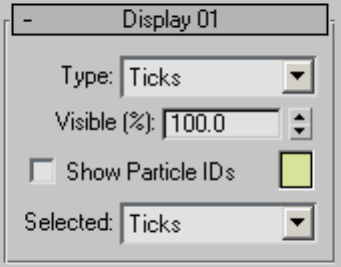
automatically inserts a Display operator in new global events, but does not
add one to new local events.
Particles in any local event that doesn't contain a Display operator don't appear
in the viewports, unless an associated global event contains a Display operator
(that is, a global Display operator). If a particle is affected by multiple Display
operators (for example, both global and local operators) simultaneously, the
software generates all viewport particle representations at the same time.
See also:
■Render Operator on page 2872
Interface
The user interface appears in the parameters panel, on the right side of the
Particle View dialog.
Type Choose how particles appear in the viewports. The two-dimensional
particle markers depict position only. Geometry shows how particles will
actually render, in three dimensions; Lines shows speed and direction of
motion; and Bounding Boxes reflects scale and orientation.
In the following list, each choice's description is preceded by the number of
dimensions used by each particle representation:
■None Particles do not appear in the viewports.
■Dots (0D) Each particle appears as a single pixel.
■Ticks (2D) Each particle appears as a + sign.
■Circles (2D) Each particle appears as a small circle.
Particle Flow | 2865

■Lines (1D) Each particle appears as a line, one pixel thick. The line's
length indicates particle speed, and its orientation reflects the direction of
motion. Use this option for fast, accurate feedback when experimenting
with the Speed operators.
TIP When using the Lines display type with the OpenGL display driver,
slow-moving particles might not appear properly in the viewports. In such
cases, to see all particles, add a second Display operator in the same event and
set its Type to Dots.
■Bounding Boxes (3D) Each particle appears as a bounding box. Use this
option for a good representation of the final animation, at a slight cost in
computational speed.
■Geometry (3D) Each particle appears as its actual geometry. Use this
option for the best representation of the final animation, at the greatest
cost in computational speed.
■Diamonds (2D) Each particle appears as a diamond.
■Boxes (2D) Each particle appears as a small square.
■Asterisks (2D) Each particle appears as an asterisk (*).
■Triangles (2D) Each particle appears as a small triangle.
Visible % Specifies the percentage of particles visible in the viewports. This
option lets you speed up viewport redrawing by reducing the number of visible
particles.
Show Particle IDs When on, each particle's unique index number is visible
in the viewports. Particles are numbered in the order of their birth, starting
with 1 for the first particle born.
[color swatch] Shows the color for particles displayed using options other
than Geometry, as well as for the particle IDs. The software chooses a different
color at random for each Display operator added to the system. In addition
to the Type options, using different colors helps to distinguish among particles
in different events.
To change the color, click the color swatch and use the Color Selector dialog
to choose a new color.
If a system has a global Display operator, and you select its Source icon in a
viewport, then you can change the color of the global Display operator from
the color swatch on the Modify panel. However, changing the global Display
2866 | Chapter 12 Space Warps and Particle Systems
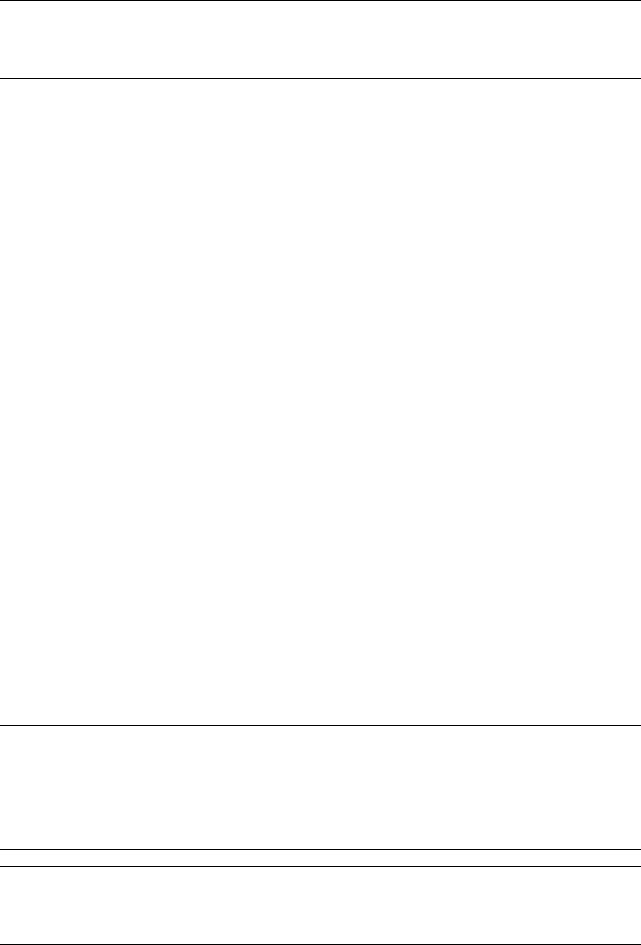
operator's color in Particle View does not change the color of the swatch on
the Modify panel.
NOTE When a Particle Flow source icon is selected, all of its non-selected particles,
other than those shown as geometry, are colored white in the viewports. To see
all assigned particle colors, deselect the particle system.
Selected Choose how selected particles on page 2753 appear in the viewports.
The choices are the same as for Type, above.
Force Operator
Particle View on page 2730 > Click a Force operator in an event or add a Force
operator to the particle system and then select it.
The Force operator lets you influence particle motion with one or more space
warps from the Forces category. Use this operator along with different forces
to simulate the effects of wind, gravity, and so on. The following force space
warps work with the Force operator:
■Displace on page 2645
■Drag on page 2624
■Gravity on page 2639
■Motor on page 2614
■PBomb on page 2629
■Push on page 2609
■Vortex on page 2619
■Wind on page 2642
NOTE By default, the influence of these space warps on Particle Flow particles is
equivalent to their influence on the 3ds Max 2 particle systems: PArray, Super
Spray, Blizzard, and PCloud. To obtain an influence on Particle Flow particles
equivalent to that of the 3ds Max 1 particle systems Snow and Spray, set Influence
on page 2870 to 100.0.
TIP To make the particles follow a path, use the Speed By Icon operator on page
2796 and use Path Constraint to assign its icon to the path. For a procedure, see
Example: To send particles along a path: on page 2797 .
Particle Flow | 2867

To employ deflectors for particle dynamics, with or without the Force operator,
use the Collision test on page 2881 and Collision Spawn test on page 2885 .
Script Wiring rollout
This rollout appears in the parameters panel below the main operator rollout
after you highlight the operator, right-click it, and then choose Use Script
Wiring. Thereafter, a check mark appears next to the Use Script Wiring in the
right-click menu, and the rollout appears whenever you highlight the operator.
To turn off script wiring, choose Use Script Wiring again from the right-click
menu.
Script wiring lets you use a script to control parameters that you normally
specify in the operator's parameters. Place a Script operator on page 2874 before
the Force operator in the event, and then use it to define values in the
particleFloat channel. You'll find an example script below.
Use Script Float As Choose either of the following:
■Not Used Particle Flow uses the Influence setting on page 2870 specified
in the Parameters rollout.
■Influence Particle Flow applies the script to the Influence setting.
particleFloat Sample Script
NOTE See this topic in the online User Reference for the particleFloat sample
MAXScript code.
Procedures
To affect particle motion with force space warps:
1Add one or more force space warps to the scene, and set them up as
necessary.
2In Particle View, add a Force operator to any events in which particles
are to be affected by the forces. To affect particles in all events, add the
Force operator to the PF Source instead.
3Highlight the Force operator, and then use the Add or By List button to
apply the force space warps to the operator.
2868 | Chapter 12 Space Warps and Particle Systems
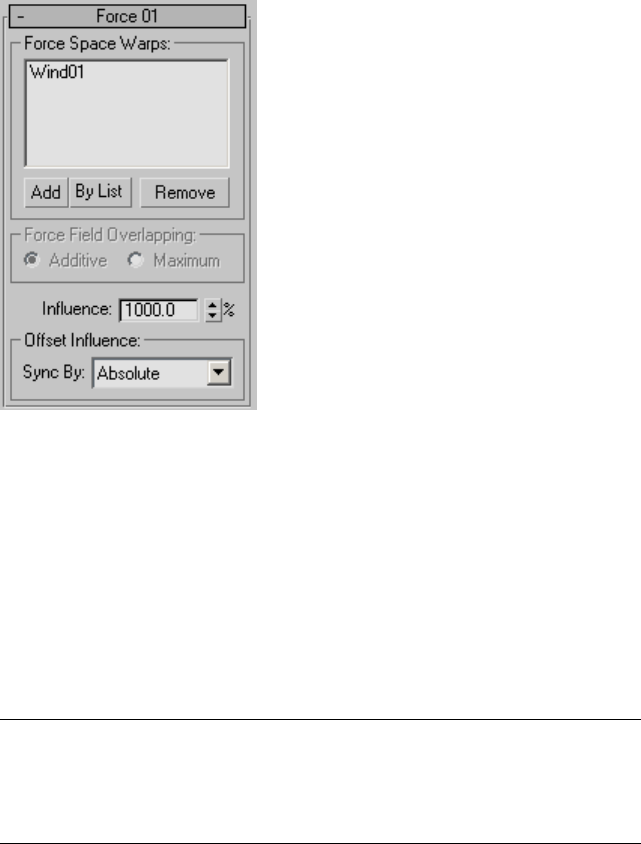
Interface
The user interface appears in the parameters panel, on the right side of the
Particle View dialog.
Force Space Warps group
This group displays the forces currently in effect, and let you add and remove
forces.
[List] Shows the forces that apply to this operator. If more than three forces
apply, a scroll bar appears at the right side of the list.
If you delete a listed space warp from the scene, its name is replaced in the
list by the entry “<deleted>”.
NOTE Particle Flow applies the forces to particle motion in the order in which the
space warps appear in the list; the effect is cumulative in top-to-bottom order.
First, the topmost space warp is applied to particle motion, then the second space
warp is applied to the result of the first space warp, and so on. Changing the order
can alter the final result.
Add Click this button, and then select a force space warp in the scene to
add it to the end of the list.
Particle Flow | 2869

By List Click this button, and then use the Select Force Space Warps dialog
to add one or more space warps to the list. The space warps must already exist
in the scene.
The software adds space warps to the list in same order in which they appear
in the dialog. To effect a different order, use the Add button to add them one
at a time.
Remove Highlight a space warp in the list, and then click this button to
remove it from the list. Any removed space warps remain in the scene.
Force Field Overlapping Determines how multiple forces that occupy the
same volume of space affect the particles. With Additive, the forces are
combined according to their relative strengths. With Maximum, only the
force with the greatest strength affects the particles.
For example, you might apply Wind and Gravity space warps to particles, and
set their Strength parameters to 1.5 and 1.0, respectively. If you choose
Additive, the Wind space warp will have approximately 50 percent more
influence over the particles than the Gravity space warp. But if you choose
Maximum, only the Wind space warp will affect the particles.
Influence Specifies the strength with which the force or forces are applied
to the particles as a percentage. Default=1000.0.
A negative Influence value reverses the force effects.
NOTE By default, the influence of the Force space warps on Particle Flow particles
is equivalent to their influence on the 3ds Max 2 particle systems PArray, Super
Spray, Blizzard, and PCloud. To obtain an influence on Particle Flow particles
equivalent to that of the 3ds Max 1 particle systems Snow and Spray, set Influence=
100.0 .
Offset Influence group
Choose the time frame for applying animated parameters. For an explanation,
see Animation Offset Keying group on page 2790 .
Sync By Choose the time frame for applying animated parameters:
■Absolute Time Any keys set for parameters are applied at the actual frames
for which they're set.
■Particle Age Any keys set for parameters are applied at the corresponding
frames of each particle's existence.
■Event Duration Any keys set for parameters are applied to each particle
starting when it first enters the event.
2870 | Chapter 12 Space Warps and Particle Systems
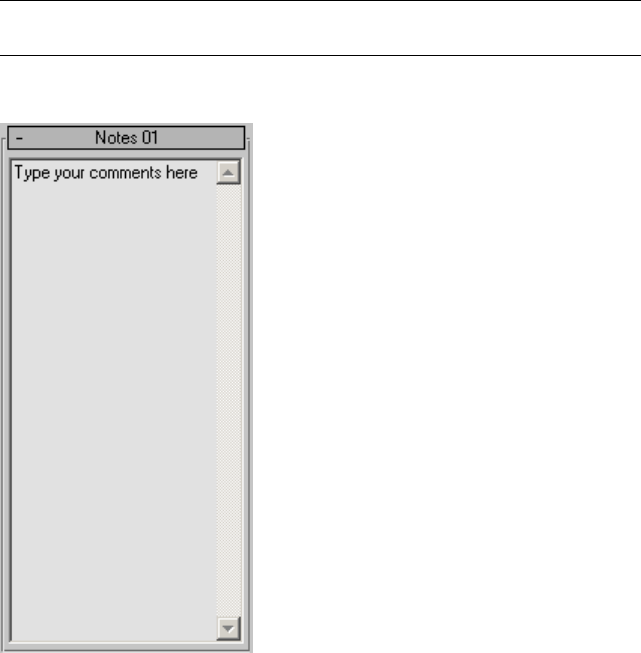
Notes Operator
Particle View on page 2730 > Click Notes in an event or add a Notes operator
to the particle system and then select it.
The Notes operator lets you add a textual comment to any event. It doesn't
have any direct effect on the particle system, but it helps you keep track of
the overall function of each event.
NOTE You can also add a comment directly to an event or action by right-clicking
it and choosing Comments.
Interface
The user interface appears in the parameters panel, on the right side of the
Particle View dialog.
The interface is a simple text box. Click in the box and enter your text.
Particle Flow | 2871
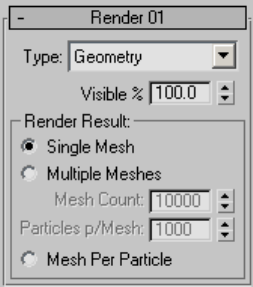
Render Operator
Particle View on page 2730 > Click a Render operator in an event or add a Render
operator to the particle system and then select it.
The Render operator provides controls related to rendering particles. You can
specify the form that rendered particles are to take, and how to convert the
particles to individual mesh objects for rendering purposes.
Interface
The user interface appears in the parameters panel, on the right side of the
Particle View dialog.
Type Lets you render particles as bounding boxes or geometry, or disable
the particle system at render time, or enable the particle system but prevent
it from sending renderable particles to the 3ds Max renderer.
Default=Geometry.
■None The particle system (or event, if used locally) is considered
non-renderable, and therefore is never evaluated during render.
■BoundingBox Particles render as boxes whose sizes represent the particle
geometry extents.
Use this option with complex particle systems to speed up test renders.
■Geometry Particles render with their actual geometry.
Use this option with simpler particle systems, and for the final render.
■Phantom Use this option when you want Particle Flow to function
normally, calculating the animation at each frame, but not to render
geometry directly. An example would be when you're using a Final Step
2872 | Chapter 12 Space Warps and Particle Systems

Update script on page 2757 to pass data from the particle system to other
objects in the scene.
Visible % The percentage of particles that render. Range=0 to 100.
Default=100.
Lower this value for faster rendering of complex particle systems.
You can also reduce the number of particles in the system at render time with
the Quantity Multiplier > Render setting on page 2752 .
Render Result group
These settings determine how the system converts particles to mesh format
for rendering. By default, the software renders all particles as a single mesh
per event, which provides for the most efficient operation under most
conditions. However, in some situations each particle should be converted to
an individual mesh object by turning on Mesh Per Particle. For example, with
particles each of whose face count exceeds 10,000, it's most efficient to render
a mesh per particle. Alternatively, you can opt to combine particles into
multiple meshes by specifying a face count and number of particles per mesh.
Certain renderers might require a non-default setting for Render Result. Consult
the renderer documentation for further information.
NOTE The number of particles Particle Flow can handle per frame is limited only
by system resources, but each single mesh is allowed a maximum of 5,000,000
faces or vertices. If the total number of faces or vertices in a mesh exceeds
5,000,000, Particle Flow ignores particles beyond this limit.
Single Mesh Sends the renderer one mesh object comprising all particles in
the system.
Multiple Meshes Sends the renderer the specified number of mesh objects,
each containing the specified number of particles. If the result of dividing the
total number of particles by the Particles p/Mesh value is less than the specified
Mesh Count value, some of the meshes might contain few or no faces.
This is a compromise method of operation, and can be used with renderers
that cannot handle all particles in a single mesh, but can deal with groups of
particles of a certain size.
Mesh Count The maximum number of mesh objects that Particle Flow will
send to the renderer.
Particles p/Mesh The number of particles that each mesh object will
comprise.
Particle Flow | 2873
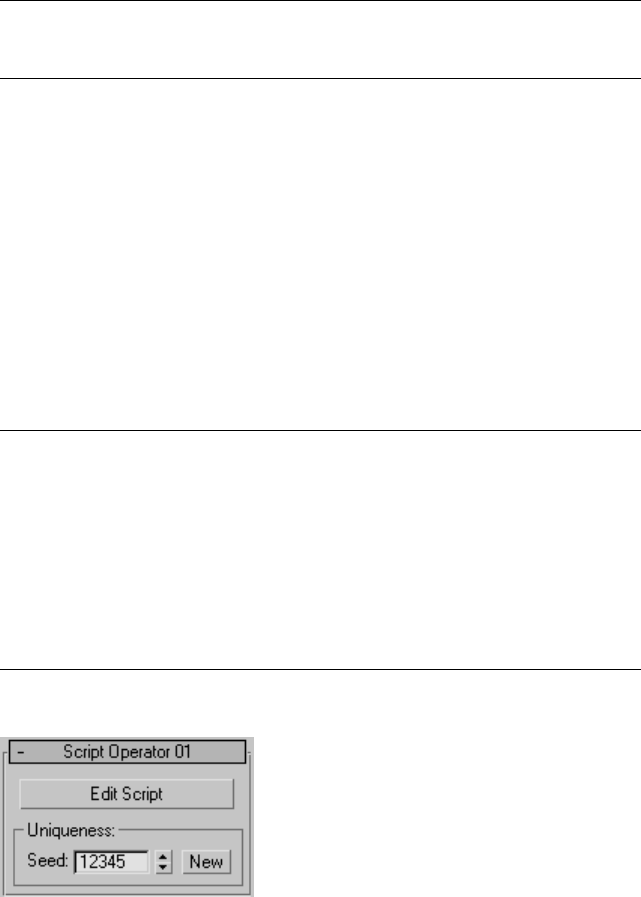
Mesh Per Particle Sends the renderer a separate mesh for each particle.
This is the least efficient method of operation, but might be required by certain
renderers.
NOTE With the default scanline and mental ray renderers, this method does not
support rendering of particles born after the start of the rendered frame sequence.
In general, use Mesh Per Particle only with renderers that require it.
Script Operator
Particle View on page 2730 > Click Script Operator in an event or add a Script
Operator to the particle system and then select it.
The Script operator enables control of particles within the Particle Flow system
using a MAXScript script. The script can use any program functionality
available to MAXScript.
When you add a new Script operator, it contains a default script that slows
particles, and then, when they are slow enough, splits off the first 50 particles
into a stream traveling in a negative direction on the world X axis, and the
remainder traveling in the opposite direction.
TIP You can use MAXScript to align particle scale with the underlying bitmap,
thus providing a “scale bitmap” function. This requires a sandwich with three
operators: two Script operators, and a Speed By Surface operator in between. The
first Script operator reads the current speed vector into the MXVector channel,
thus caching the current speed. The Speed By Surface operator changes the speed
according to the underlying bitmap. And the second Script operator reads the
speed channel into a temporary variable, restores the speed from the MXVector
channel (the cached value), and uses the temporary variable to define the scale.
This way, the original speed is restored, and the scale value is defined by the
bitmap.
Interface
2874 | Chapter 12 Space Warps and Particle Systems
The user interface appears in the parameters panel, on the right side of the
Particle View dialog.
Edit Script Click this button to open the current script in a MAXScript Editor
window.
For detailed information about the MAXScript utility, open the MAXScript
Reference, available from Help menu > MAXScript Reference.
Uniqueness group
The Uniqueness setting provides a randomization seed that the script can use
or ignore.
Seed Specifies a randomization value.
New Calculates a new seed using a randomization formula.
Flows
The flows category contains two operators for creating initial particle system
setups. These are:
Empty Flow on page 2875
Standard Flow on page 2876
See also:
■Operators on page 2761
■Tests on page 2877
Empty Flow
Particle View on page 2730 > depot
Empty Flow provides a starting point for a particle system consisting of a single
global event containing a Render operator. This lets you build a system
completely from scratch, without having first to delete the default operators
provided by the Standard Flow system.
To use Empty Flow, drag it from the depot to the event display. In Particle
View, this creates a global event containing a single Render operator. If the
Particle Flow | 2875
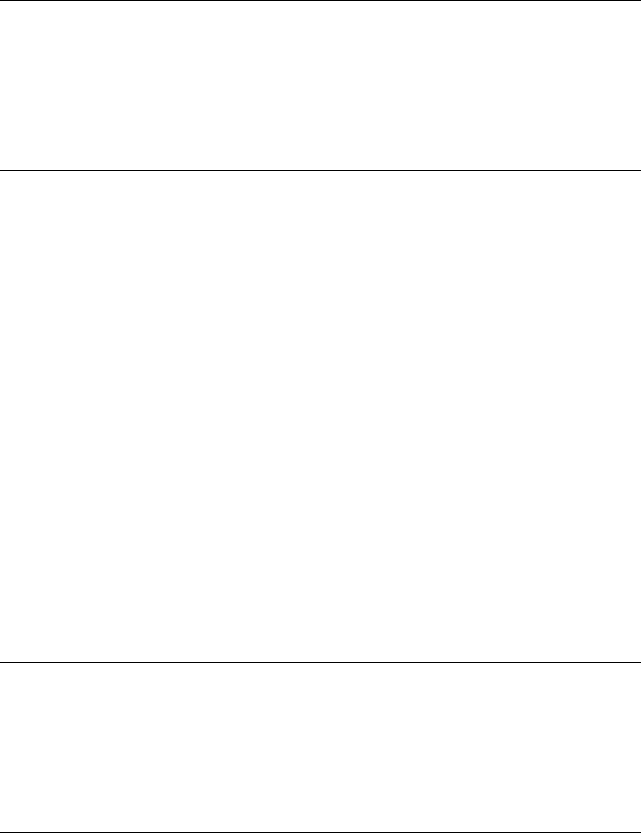
Global default display option is active in the Particle View > Options menu,
the global event will also contain a Display operator. Adding an Empty Flow
also creates a Particle Flow Source icon in the viewports, at the world origin
(0,0,0).
NOTE If an orthogonal viewport is active when you add an Empty Flow to the
system, the software orients the new source icon parallel to the plane of the active
viewport, with the default emission direction pointing forward. For example, if
the Front viewport is active, the icon is oriented parallel to the XZ plane in the
world coordinate system, with the default emission direction along the positive Y
axis. If a Camera or Perspective viewport is active, Particle Flow uses the default
orientation: parallel to the XY plane, pointing in the negative Z direction.
See also:
■Standard Flow on page 2876
Standard Flow
Particle View on page 2730 > depot
Standard Flow provides a starting point for a particle system consisting of a
global event containing a Render operator, wired to a birth event containing
a Birth, a Position, a Speed, a Rotation, a Shape, and a Display operator, with
all parameters set to default values. This is the same system that the software
creates automatically when you add a Particle Flow icon to the viewport.
To use Standard Flow, drag it from the depot to the event display. In Particle
View, this creates the particle system described above. If the Global default
display option is active in the Particle View > Options menu, the global event
will also contain a Display operator. Adding a Standard Flow also creates a
Particle Flow Source icon in the viewports, at the world origin (0,0,0).
NOTE If an orthogonal viewport is active when you add a Standard Flow to the
system, the software orients the new source icon parallel to the plane of the active
viewport, with the default emission direction pointing forward. For example, if
the Front viewport is active, the icon is oriented parallel to the XZ plane in the
world coordinate system, with the default emission direction along the positive Y
axis. If a Camera or Perspective viewport is active, Particle Flow uses the default
orientation: parallel to the XY plane, pointing in the negative Z direction.
2876 | Chapter 12 Space Warps and Particle Systems

See also:
■Empty Flow on page 2875
Tests
The basic function of a test in Particle Flow is to determine whether particles
satisfy one or more conditions, and if so, make them available for sending to
another event. When a particle passes a test, it is said to “test True.” To send
eligible particles to another event, you must wire the test to that event. Particles
that don't pass the test (“test False”) remain in the event and are repeatedly
subjected to its operators and tests. Or, if the test isn't wired to another event,
all particles remain in the event. You can use several tests in an event; the
first test checks all particles in the event, and each test after the first checks
only particles that remain in the event.
One test, Spawn, doesn't actually perform a test, but simply creates new
particles from existing ones, and sets the new particles' test result to True so
they're automatically eligible for redirection to another event. And the Send
Out test simply sends all particles to the next event by default.
Some tests can also serve as operators, in that they contain parameters that
modify particle behavior. If you don't wire a test to another event, it functions
only as an operator; the test aspect doesn't affect particle flow.
TIP Always place a test at the end of its event, unless you have specific reasons
for placing it elsewhere. That way, all preceding actions can take effect during
each integration step before the test is evaluated.
All the tests are grouped together in the Particle View depot, and are listed in
alphabetical order. All test icons are the same: a yellow diamond containing
a simplified diagram of an electrical switch.
Particle Flow | 2877
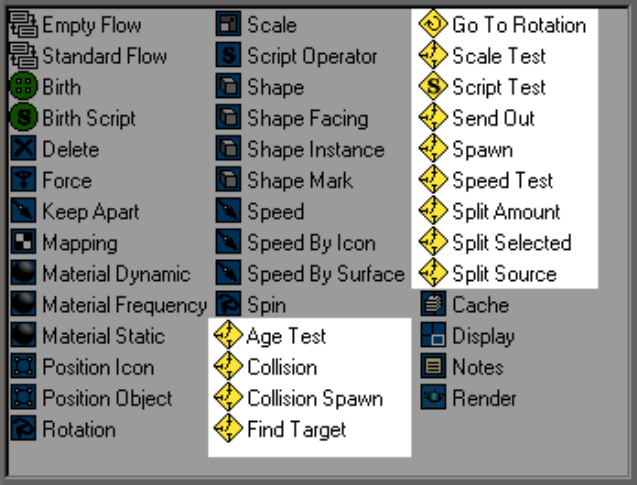
The Particle Flow tests in the Particle View depot
The tests are:
Age Test on page 2879
Collision Test on page 2881
Collision Spawn Test on page 2885
Find Target Test on page 2891
Go To Rotation Test on page 2902
Scale Test on page 2908
Script Test on page 2911
Send Out Test on page 2912
Spawn Test on page 2912
Speed Test on page 2917
Split Amount Test on page 2920
Split Selected Test on page 2921
2878 | Chapter 12 Space Warps and Particle Systems
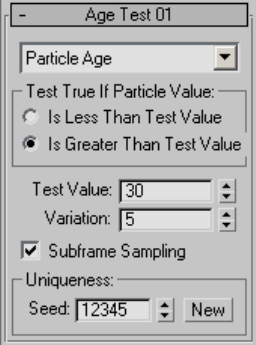
Split Source Test on page 2922
See also:
■Operators on page 2761
■Flows on page 2875
Age Test
Particle View on page 2730 > Click Age Test in an event or add Age Test to the
particle system and then select it.
Age Test lets the particle system check whether a specific amount of time has
passed since the start of the animation, or how long a particle has existed, or
how long a particle has been in the current event, and branch accordingly.
Interface
The user interface appears in the parameters panel, on the right side of the
Particle View dialog.
The first interface element is a drop-down list that lets you choose the type
of age to test. Default=Particle Age.
■Absolute Age Tests the current frame number in the animation.
Particle Flow | 2879
■Particle Age Tests the current age of each particle in frames. This is the
default test type.
■Event Age Tests the current duration of the current event in frames.
Test True if Particle Value Lets you specify whether the test passes particles
on to the next event if the age test succeeds or fails. Default=Is Greater Than
Test Value
By default, Age Test returns True if the value tested for exceeds the Test Value
quantity, but you can alternatively choose Is Less Than Test Value. For example,
if you use the Absolute Age test type and set Test Value=60 and Variation=0,
and choose Is Less Than Test Value, then particles will move to the next event
only until frame 60. After frame 60, any remaining particles stay in the current
event unless another test returns True.
Test Value The specific frame number, particle age (in frames), or event
duration (in frames) to test for. Default=30.
This value cannot be animated.
Variation The number of frames by which the value tested for can vary
randomly. Default=5.
This value cannot be animated.
To obtain the actual test value for each particle, the system multiplies the
Variation value by a random number between -1.0 and 1.0, and then adds the
result to the Test Value setting. For example, if Test Value=300 and
Variation=10, then tested value for each particle would be between 290 and
310.
Subframe Sampling Turning this on helps avoid particle "puffing" when
passing particles to the next event by testing the time at a much higher
subframe resolution (that is, throughout each frame), rather than using the
relatively coarse frame resolution. Default=on.
"Puffing" is the effect of creating separate "puffs" or clusters of particles, rather
than a continuous stream.
Turn off Subframe Sampling to cause the test to be executed exactly at frame
times.
Uniqueness group
The Uniqueness setting enables randomization of the test value variation.
Seed Specifies a randomization value.
2880 | Chapter 12 Space Warps and Particle Systems

New Calculates a new seed using a randomization formula.
Collision Test
Particle View on page 2730 > Click Collision in an event or add Collision to the
particle system and then select it.
Collision tests for particles that collide with one or more specified Deflector
space warps. It can also test whether a particle has slowed down or sped up
after one or more collisions, has collided more than once, and even whether
it will collide with a deflector in a specified number of frames.
The Collision test supports all deflector space warps except the DynaFlect
deflectors:
■POmniFlect on page 2650
■SOmniFlect on page 2661
■UOmniFlect on page 2664
■SDeflector on page 2669
■UDeflector on page 2672
■Deflector on page 2675
TIP When testing for collisions with multiple deflectors, for best results, place all
the deflectors in a single Collision test. This tests for collisions with all the deflectors
simultaneously, and helps avoid possible missed collisions.
See also:
■Collision Spawn Test on page 2885
Procedures
Example: To test for particles slowing down after one or more collisions:
In the real world, particles bouncing repeatedly against a surface lose kinetic
energy at each collision, and slow down gradually. Rather than testing for a
specific number of bounces, you can use the Is Slow After Collision(s) to test
whether particle speed has sunk below a specific level.
1Start or reset 3ds Max. Set the animation length to 500 frames.
Particle Flow | 2881
2Add a Gravity space warp and a Deflector space warp. Decrease the
deflector's Bounce setting below 1.0, and increase the Variation and Chaos
values above 0.0. Set the deflector's Width and Length to 500.
3Create a default Particle Flow system. Position the emitter directly above
the deflector.
4Add a Force operator on page 2867 to the end of Event 01 and add the
Gravity space warp to the Force operator.
5Create a new event with a Display operator on page 2864 , and change the
display type to a different choice than is used in Event 01.
6Add a Collision test to Event 01, below the Force operator, and wire it to
the new event.
7In the Collision test settings, add the deflector. Choose Is Slow After
Collision(s), and set Speed Min=100 (assuming you're using the default
initial speed of 300).
8Play the animation. You might need to adjust one or more settings before
seeing the expected behavior.
After several bounces, the particles change in appearance and move
steadily away from the deflector, indicating that they've entered the
second event. Of course, you can set any behavior you like in this event.
In the next step, you'll see what happens when actions in an event are
not in the right order.
9In Event 01, move the Collision test above the Force operator, and then
play the animation.
Quite a few particles leak through the deflector. This happens because
the software first tests the particles for a collision, and then applies the
Gravity force. The particles that are approaching the deflector and are
very close to it are being tested for a collision, which tests False because
they haven't actually struck the deflector yet. The software then applies
the gravity, which pushes them past the deflector, making them no longer
eligible for testing for collision. Generally speaking, it is best to keep Force
operators above Collision tests in each event to ensure that particles don't
leak through the deflector.
2882 | Chapter 12 Space Warps and Particle Systems
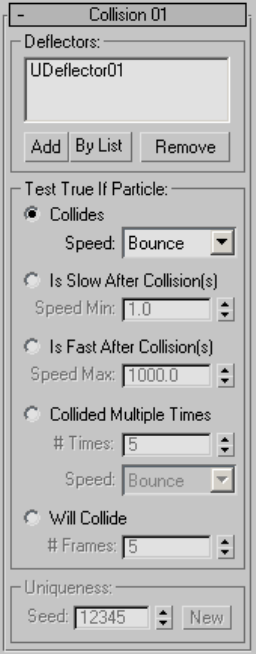
Interface
The user interface appears in the parameters panel, on the right side of the
Particle View dialog.
Deflectors group
This group displays the deflectors currently in effect, and let you add and
remove deflectors.
[list] Shows the deflectors that apply to this operator. If more than three
deflectors apply, a scroll bar appears at the right side of the list.
If you delete a listed space warp from the scene, its name is replaced in the
list by the entry “<deleted>”.
Particle Flow | 2883
Add Click this button, and then select a Deflector space warp in the scene
to add it to the list.
By List Click this button, and then use the Select Deflectors dialog to add
one or more space warps to the list. The space warps must already exist in the
scene.
Remove Highlight a deflector in the list, and then click this button to remove
it from the list. Any removed space warps remain in the scene.
Test True If Particle group
Choose the condition under which the test will pass particles on to the next
event, and then adjust the associated setting or settings. Default=Collides.
Collides Choose this option, and then set Speed according to how particle
speed should be affected by the collision.
Speed Choose one of the following. Default=Bounce.
■Bounce The speed and direction after collision is determined by the
deflector properties.
■Continue Particle speed and direction are unaffected by the collision.
■Stop Particle speed is set to 0 after the collision.
■Random Particles bounce off the deflector in random directions.
Is Slow After Collision(s) The test succeeds if, after collision, particle speed
is less than the Speed Min value.
With this choice, particle behavior with respect to the deflector(s) is the same
as with the Collides > Bounce option.
Speed Min Particles traveling at less than this speed, in system units per
second, test True and become eligible for moving to the next event.
Default=1.0.
Is Fast After Collision(s) The test succeeds if, after collision, particle speed
is greater than the Speed Max value.
With this choice, particle behavior with respect to the deflector(s) is the same
as with the Collides > Bounce option.
Speed Max Particles traveling faster than this speed, in system units per
second, test True and become eligible for moving to the next event.
Default=1000.0.
2884 | Chapter 12 Space Warps and Particle Systems
Collided Multiple Times The test becomes True after a particle collides a
specific number of times. The particle is moved to the point of the last collision
and then redirected to the next event.
# Times The number of times a particle must collide in order to test True.
Speed Determines speed and direction after the specified number of
collisions. See above for explanations of the choices.
Will Collide The software extrapolates particle motion in a linear fashion,
based on the current direction and speed, and the test becomes True if the
results suggest that the particle will collide with the deflector during a specified
time interval. The particle is redirected to the next event without updating
its speed or position.
# Frames The number of frames ahead during which the software looks for
an impending collision.
Uniqueness group
The Uniqueness setting enables randomization of the Random options in the
Speed drop-down lists.
Seed Specifies a randomization value.
New Calculates a new seed using a randomization formula.
Collision Spawn Test
Particle View on page 2730 > Click Collision Spawn in an event or add Collision
Spawn to the particle system and then select it.
Collision Spawn creates new particles from existing ones that collide with one
or more Deflector space warps. You can specify different post-collision behavior
for the colliding particles and their offspring. Each spawned particle is born
at the same location as its parent, and has the same orientation and shape.
Collision Spawn can give the spawned particles a different speed and scaling
factor. If you wire the Collision Spawn test to another event, spawned particles
are sent to that event, where you can specify different properties for the new
particles.
Examples of Collision Spawn usage include marks or explosions resulting from
collisions between particles and objects. To achieve these effects, you can use
Collision Spawn in conjunction with the Shape Mark on page 2832 and Shape
Facing on page 2822 operators.
Particle Flow | 2885

The Collision Spawn test supports all deflector space warps except the
DynaFlect deflectors:
■POmniFlect on page 2650
■SOmniFlect on page 2661
■UOmniFlect on page 2664
■SDeflector on page 2669
■UDeflector on page 2672
■Deflector on page 2675
TIP When testing for collisions with multiple deflectors, for best results, place all
the deflectors in a single Collision Spawn test. This tests for collisions with all the
deflectors simultaneously, and helps avoid possible missed collisions.
See also:
■Collision Test on page 2881
■Spawn Test on page 2912
2886 | Chapter 12 Space Warps and Particle Systems

Interface
Particle Flow | 2887

The user interface appears in the parameters panel, on the right side of the
Particle View dialog.
In the context of Collision Spawn, a parent is the original particle from which
new particles are spawned.
Test True for group
These check boxes let you specify which particles, if any, should become
eligible for redirection to the next event upon satisfaction of the test
conditions.
NOTE After a particle tests True, the Collision Spawn test no longer tests the
particle for collision. If you simply want particles to spawn every time they collide,
turn either or both of these off and use a different test for redirection.
Parent Particles When on, parent particles qualify for redirection when the
test conditions are met. Default=on.
When using the Spawn On First Collision option on page 2889 , Parent Particles
is available only when Delete Parent is off.
This option is also available when using the Spawn On Each Collision option
on page 2889 . In this case, parent particles test True only after colliding the
number of times specified by the Until # value.
Spawn Particles When on, spawned particles qualify for redirection when
the test conditions are met. Default=on.
Deflectors group
This group displays the deflectors currently in effect, and let you add and
remove deflectors.
[list] Shows the deflectors that apply to this operator. If more than three
deflectors apply, a scroll bar appears at the right side of the list.
If you delete a listed space warp from the scene, its name is replaced in the
list by the entry “<deleted>”.
Add Click this button, and then select a Deflector space warp in the scene
to add it to the list.
By List Click this button, and then use the Select Deflectors dialog to add
one or more space warps to the list. The space warps must already exist in the
scene.
2888 | Chapter 12 Space Warps and Particle Systems
Remove Highlight a deflector in the list, and then click this button to remove
it from the list. Any removed space warps remain in the scene.
Spawn Rate And Amount group
Use these settings to specify when particles are to spawn and other values
related to how many particles are spawned.
Spawn On First Collision Particles spawn only the first time they collide with
a deflector.
Delete Parent When on, deletes each original particle from which a new
one is spawned. Available only with the Spawn On First Collision option.
Spawn On Each Collision Particles spawn on each of multiple collisions, up
to a limit specified with the Until # parameter.
Until # The maximum number of collisions by the parent particles that
produce spawned particles. Available only with the Spawn On Each Collision
option. Default=3.
When Test True For > Parent Particles is on, parent particles test True only
after colliding the number of times specified by the Until # value.
Spawnable The percentage of particles in the current event that will spawn
new particles. This is determined once for each particle, when it enters the
event. However, the parameter is animatable. Default=100.0.
For values other than 100.0, Spawnable uses a randomized selection process,
which is affected by the Uniqueness Seed value. For example, with five parent
particles, Offspring #=1, and Spawnable=80.0, you might get any number of
spawned particles between two and five for each collision. The average per
spawning would be four, however.
Offspring # The number of new particles the system creates from each parent
particle for each spawning event. Default=1.
Variation The amount by which the Offspring # value can vary randomly.
Default=0.0.
To obtain the actual test value for each particle, the system multiplies the
Variation value by a random number between -1.0 and 1.0, and then applies
the result as a percentage of the Offspring # setting. For example, if Offspring
#=20 and Variation=10, then the actual number of offspring for each particle
would be between 18 and 22.
Particle Flow | 2889
Sync By Choose the time frame to use when animating Offspring # and
Variation:
■Absolute Time Any keys set for parameters are applied at the actual frames
for which they're set.
■Particle Age Any keys set for parameters are applied at the corresponding
frames of each particle's existence.
■Event Duration Any keys set for parameters are applied to each particle
starting when it first enters the event.
■Restart Particle Age When on, sets the age of each newly spawned particle
at 0. When off, each spawned particle inherits its parent's age. Default=on.
Speed group
Lets you specify the behavior of spawned particles, as well as their speed in
absolute terms or relative to the parents' speed, with optional random variation.
The direction of a spawned particle is always in relation to that of its parent,
but you can set a Divergence so they eventually spread out. Default=Inherited.
Parent Specify the parent's behavior. Available only when Delete Parent is
off.
■Bounce The speed and direction after collision is determined by the
deflector properties.
■Continue Particle speed and direction are unaffected by the collision.
Offspring Specify the behavior of the newly spawned particles.
■Bounce The speed and direction of offspring after collision is determined
by the deflector properties.
■Continue Speed and direction of offspring are unaffected by the collision.
In Units Choose this to specify the speed of spawned particles in system
units per second. Default=100.0.
A positive value inherits the parent's direction; a negative value reverses it.
Inherited Choose this to specify each spawned particle's speed as a percentage
of its parent's speed. Default=100.0
A positive value inherits the parent's direction; a negative value reverses it.
2890 | Chapter 12 Space Warps and Particle Systems
Variation The amount by which a spawned particle's speed can vary
randomly. Default=0.0.
To obtain the actual speed for each spawned particle, the system multiplies
the Variation value by a random number between -1.0 and 1.0, and then adds
the result to the particle's speed as specified or inherited. For example, if a
particle's speed is 100 units/second and Variation=20, then the tested value
for each particle would be between 80 and 120 units/second.
Divergence When on, spreads out the stream of spawned particles. Use the
numeric setting to define the extent of the divergence in degrees. Range=0 to
180. Default=0.
Size group
Scale Factor The amount of uniform scaling to apply to each spawned
particle, as a percentage of its parent's size. Default=100.0.
Variation The amount by which a spawned particle's scale can vary randomly.
Default=0.0.
To obtain the actual scaling for each spawned particle, the system multiplies
the Variation value by a random number between -1.0 and 1.0, and then adds
the result to the Scale Factor value. For example, if Scale Factor=100 and
Variation=20, then each spawned particle would be between 80 and 120
percent of its parent's size.
Uniqueness group
The Uniqueness setting enables randomization of the Spawnable result, when
less than 100.0, as well as of the Variation values.
Seed Specifies a randomization value.
New Calculates a new seed using a randomization formula.
Find Target Test
Particle View on page 2730 > Click Find Target in an event or add Find Target
to the particle system and then select it.
Select a Find Target icon in the viewport. > Modify panel > Parameters rollout
Create panel > Helpers > Particle Flow > Find Target
Particle Flow | 2891
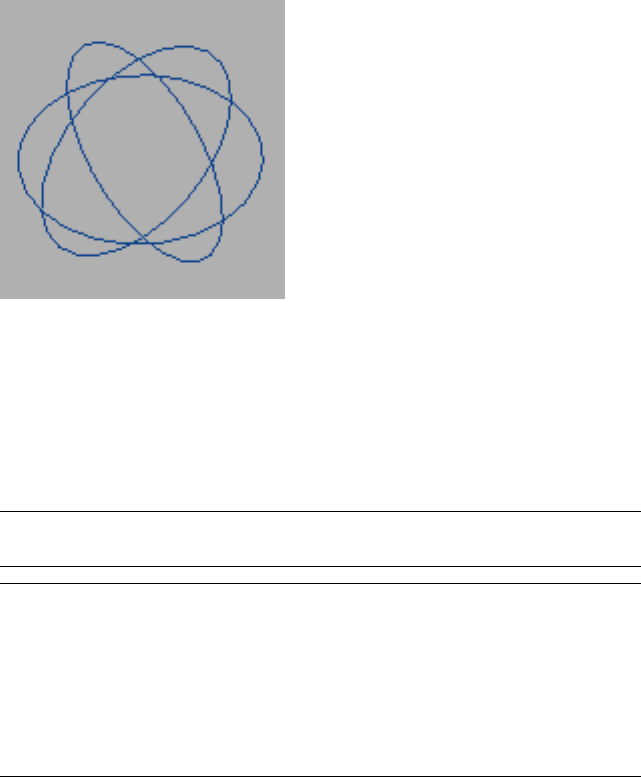
By default, Find Target sends particles to a specified target or targets. Upon
reaching a target, the particles become eligible for redirection to another event.
You can specify that the particles should use a particular speed or time frame
in moving toward the target. You can also specify where on the target the
particles should go.
Alternatively, you can use Find Target as a simple proximity test: If a particle
comes within a certain distance of its target, it becomes eligible for redirection
to the next event.
Find Target icon
When you add a Find Target test to the particle system in Particle View on
page 2730 , a spherical Find Target icon appears in the scene at the world origin
(0,0,0). You can use this icon as a target, or you can use one or more mesh
objects in the scene as targets. To display the Find Target parameters on the
Modify panel, select the icon. If you delete the icon, the software also deletes
the test.
NOTE If you add Find Target from the Create panel, Particle Flow creates a separate
event for the test in the particle diagram.
TIP In a particle loop, all particles end up at their respective starting positions,
enabling seamless repetition of the resulting animation. You can make particle
loops with Particle Flow using a Script operator and a Find Target operator. At the
start of the loop, the Script operator should read all particle positions and write
them into the MXS Vector channel. Then, at the end of the loop, set the Find
Target operator to Control by Time, set Timing to Absolute Time, set Time to the
end of the loop, and in the Target group, set Point to By Script Vector. Particle
Flow will direct particles to the previously cached position at the specified frame.
2892 | Chapter 12 Space Warps and Particle Systems

Script Operator Example
NOTE See this topic in the online User Reference to view the script operator
sample MAXScript code.
Particle Flow | 2893

Interface
2894 | Chapter 12 Space Warps and Particle Systems
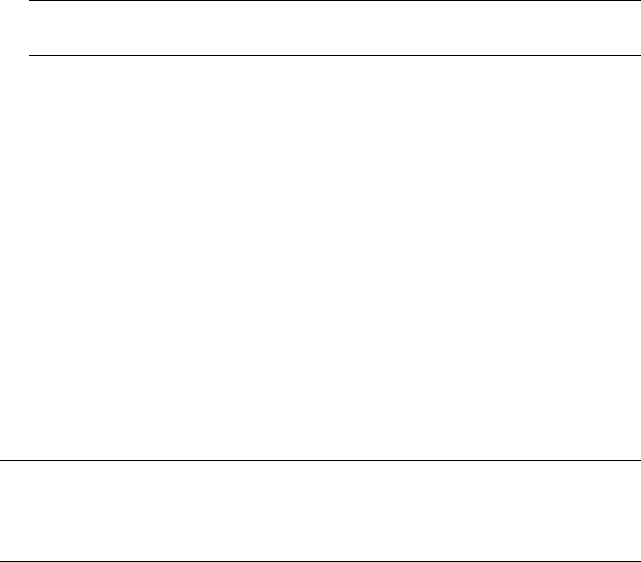
The user interface appears in the parameters panel, on the right side of the
Particle View dialog.
Control By ... The drop-down list at the top of the parameters panel lets you
choose whether to send particles to a target by specifying the speed and
acceleration, or by specifying the amount of time they should take.
Alternatively, by choosing No Control, you can test particles' distance from
a target.
■Control By Speed Specify speed and acceleration settings for the particles
to follow while traveling to the target. Use the Control By Speed group to
set the parameters.
■Control By Time Specify time-based settings for the particles to follow
while traveling to the target. Use the Control By Time group to set the
parameters.
■No Control With this option, Find Target functions only as a proximity
test. When a particle comes within the specified distance of the target, the
particles become eligible for redirection to the next event.
NOTE When you choose No Control, the Find Target test does not affect
particle speed or direction.
Test True If Distance To group
These settings let you choose which distance the Find Target test measures
and specify the measured distance. You can choose Target Pivot or Target
Point, and specify a distance with the Is Less Than setting.
Target Pivot Measures the distance between the particle and the target pivot.
If the particles are directed to the outside of the target and the Is Less Than
value is small, this condition might never be satisfied.
Target Point Measures the distance between the particle and the target point
on page 2899 .
Is Less Than When particles are closer than this distance from target pivot
or point, they test True and become eligible for redirection to the next event.
Measured in scene units.
NOTE If you set Is Less Than to 0, the particles might never test True. This might
be desirable for an animation of, for example, bees buzzing around a flower but
not landing on it. In this case, you might want to use a low value for Accel Limit
so the bees don’t circle too close to the flower.
Particle Flow | 2895

Control By Speed group
Use these settings to specify speed and acceleration parameters when using
Control By Speed or Speed Then Time. This group is available only when using
Control By Speed.
Use Cruise Speed When on, the software gives you explicit control over
particle speed and speed variation. When off, the software calculates particle
speed automatically using the Accel Limit value. Default=on.
Speed Particle speed in scene units per second. Default=300.0.
Variation The amount by which the actual Speed value can vary randomly.
Default=0.0.
To obtain the actual speed for each particle, the system multiplies the Variation
value by a random number between -1.0 and 1.0, and then applies the result
as a percentage of the Speed setting. For example, if Speed=200 and
Variation=10, then the actual speed for each particle would vary randomly
between 190 and 210.
Accel Limit Sets the acceleration limit. This value impacts the inertia and
speed of the particles. Default=1000.0.
The default acceleration limit value is based on the default Speed value of
300.0. If you change the Speed value, it is recommended that you also change
the Accel Limit value proportionately.
TIP Use a lower Accel Limit value for smooth motion, and a higher value when
greater accuracy is needed, such as when the particles should hit a small target.
You can animate this setting (use Sync By > Event Duration) to specify different
appropriate values, depending on the required results.
Ease In % Controls the rate by which particles slow down when it approaches
the target point.
The software calculates the final speed with this formula: (100% - Ease In) *
Speed. Therefore, if the Ease In value is 100%, a particle should approach the
target with a speed of 0, and if Ease In is 0%, the particle doesn't slow down
at all when approaching the target. At intermediate values, the speed is
calculated according to the distance to the target point, as linear interpolation
between the initial (cruise) speed, and the final speed. When a particle enters
the event, the distance to the target point is calculated and later used for the
interpolation. Default=0.0.
2896 | Chapter 12 Space Warps and Particle Systems
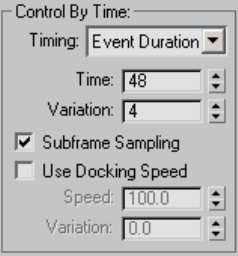
Sync By Choose the time frame to use when animating Speed, Variation,
and Accel Limit:
■Absolute Time Any keys set for parameters are applied at the actual frames
for which they're set.
■Particle Age Any keys set for parameters are applied at the corresponding
frames of each particle's existence.
■Event Duration Any keys set for parameters are applied to each particle
starting when it first enters the event.
Control By Time group
Lets you specify the amount of time particles should take to reach the target.
This group is unavailable when using Control By Speed.
Timing Determines how the software applies the specified timing, defined
by the Time and Variation values. The possible options are:
■Absolute Time Time refers to the overall time of the system. Each particle
will reach its target at the frame number specified by Time.
■Particle Age Time refers to the time elapsed since the birth of the particle.
Each particle will reach its target when its age reaches the value specified
by Time.
■Event Duration Time refers to the time elapsed since the particle entered
the current event. Each particle will reach its target when it has been in
the current for the number of frames specified by Time.
Time The number of frames particles should take to reach the target.
Default=60.
Particle Flow | 2897
Variation The number of frames by which Time can vary randomly.
Default=5.
To obtain the actual time to the target for each spawned particle, the system
multiplies the Variation value by a random number between -1.0 and 1.0, and
then adds the result to the Time value. For example, if Time=60 and
Variation=20, then the time to target for each particle would be between 40
and 80 frames.
Subframe Sampling Turning this on helps avoid particle "puffing" by timing
particles at a much higher subframe resolution (that is, throughout each
frame), rather than using the relatively coarse frame resolution. Default=on.
"Puffing" is the effect of clustering particles, rather than producing a continuous
stream. This effect is especially noticeable when the emitter is animated.
Use Docking Speed Lets you specify particles' speed when they reach the
target.
A particle might be required to reach the target from a specific direction at a
specific speed. When Use Docking Speed is off, the software calculates a path
for particles to reach the target in the shortest distance with the least
acceleration along the path. When Use Docking Speed is on, the software
calculates particles' final speed when they reach the target using the Speed
and Variation parameters. Therefore if you want a “smooth landing,” set Speed
to 0.0. Default=off.
Speed The speed of particles when they reach the target in scene units per
second. Default=100.0.
Variation The amount by which the actual Speed value can vary randomly.
Default=0.0.
Target group
By default, Find Target uses its own target icon, but you can use these controls
to designate other scene objects as targets instead.
Icon Use the Find Target icon as the target.
Each Find Target test has its own target icon. Even if you don't use it as a
target, it still influences particle behavior if you set the docking type to Parallel,
Spherical, or Cylindrical.
Mesh Objects Use one or more scene mesh objects as targets. Choose this
to make the list and list-management buttons available.
2898 | Chapter 12 Space Warps and Particle Systems
If you designate more than one target, the target used by each particle is
determined by the choice in the Object drop-down list on page 2900 in this
group.
[list] Shows the mesh objects used as targets. If more than three target objects
apply, a scroll bar appears at the right side of the list.
Add Click this button, and then select a mesh object in the scene to add it
to the list as a target.
By List Click this button, and then use the Select Target Objects dialog to
add one or more mesh objects to the list. The objects must already exist in
the scene, and the dialog shows only eligible objects.
Remove To remove a target object from the list, first highlight it and then
click this button. Any removed objects remain in the scene.
Sync By Choose the time frame to use when sending particles toward
animated objects when using Animated Shape or Follow Target Animation:
■Absolute Time Animation derived from the target is applied to particles
immediately.
■Particle Age Animation derived from the target is applied to particles at
the corresponding frames of each particle's existence.
■Event Duration Animation derived from the target is applied to particles
is applied to each particle starting when it first enters the event.
Animated Shape Turn on to allow particles to target the surface of an object
whose form is animated by scaling, by morphing, or with modifiers. This
requires more computation, because the destination must be updated at every
integration step.
Follow Target Animation Turn on to allow particles to follow a moving
target; that is, a target whose location is animated. This requires more
computation, because the destination must be updated at every integration
step.
Point Lets you specify where on its target a particle should land.
■Random Each particle targets a random point on the target.
■Closest Surface Each particle targets the nearest point of the target’s
surface.
Particle Flow | 2899

■By Script Vector The target point or points are defined using a Script
operator that defines values in the particleVector channel. The Script
operator can be anywhere upstream of the Find Target test.
NOTE When using By Script Vector to target absolute positions, such as vertex
locations, be sure to set Target to Icon. If you set it to Mesh, the positions
specified by the script will be relative to the position of the mesh object. This
latter option is useful for placing scripted targets on the surface of a moving
object.
Object With multiple mesh targets, lets you specify how the software should
choose among them. Available only when targeting more than one object.
■Random For each particle, the software chooses a target object at random.
■Closest Pivot For each particle, the software chooses as its target the
object whose pivot is nearest to the particle.
■Closest Surface For each particle, the software chooses as its target the
object whose surface is nearest to the particle.
■Least Deviation For each particle, the software chooses as its target the
object that requires the least change in its current direction (or resteering)
to reach.
■By Script Integer For each particle, the choice of a targeted object is
defined by a script operator that sets an index. This index corresponds to
a target-object entry position in the target list. See Script Operator Example
on page 2893 .
Lock On Target Object When on, the software calculates each particle's target
object once: when the particle enters the event. Thereafter, the particle is
“locked on” to its target object. When off, the software can continually
recalculate the target object for each particle. Available only when multiple
target objects are designated.
For example, if you set particles to target the closest surface, due to the target
animation and particle movement, the definition of the closest surface is
constantly changing. Thus the particle may change the target object due to
the circumstances.
2900 | Chapter 12 Space Warps and Particle Systems
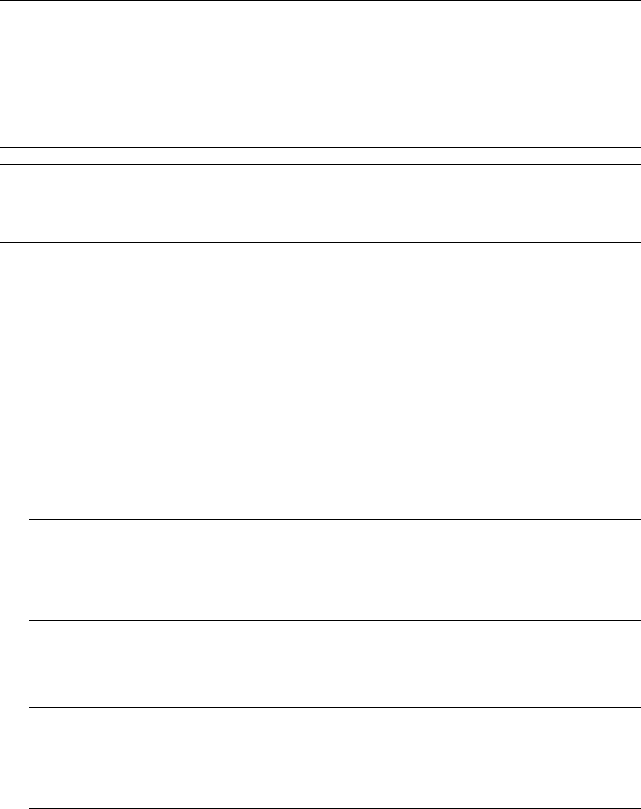
NOTE Each time Find Target sets a target object, it “locks on” to a specific point
on that object. This point can change only if the target object changes. Thus, with
a single target object, the target point always remains constant relative to the
target object . That is, if the target object or its surface is animated, and Follow
Target Animation or Animated Shape is on, the absolute coordinates of the target
point may change.
NOTE When Lock On Target Object is off, more calculation is required because
the system might have to recalculate each particle's optimal target point in each
frame.
Docking Direction group
Docking type Lets you specify from which direction particles should approach
targets.
■None Specified No docking constraints. Particles reach their targets in
the most efficient way, based on their assigned parameters and their current
attributes.
■Along Icon Arrow The final direction is the same as the Find Target icon
arrow.
NOTE When using this option, arrows appear on the Find Target icon to
indicate the direction particles will use for docking. You can change the docking
direction by reorienting the icon. This applies even when using mesh objects
as targets.
■Icon Spherical The final direction points toward the center of the operator
icon.
NOTE When using this option, arrows appear on the Find Target icon to
indicate the directions particles will use for docking. You can change the
docking directions by reorienting the icon. This applies even when using mesh
objects as targets.
■Icon Cylindrical The final direction points toward the icon arrow as a
line, thus forming a cylindrical field with the arrow as the cylinder's main
axis.
Particle Flow | 2901
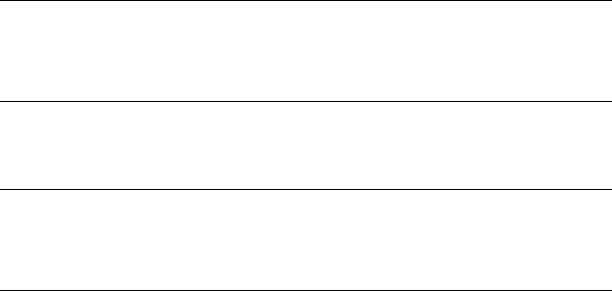
NOTE When using this option, arrows appear on the Find Target icon to
indicate the directions particles will use for docking. You can change the
docking directions by reorienting the icon. This applies even when using mesh
objects as targets.
■Surface Normals Each particle reaches its target point from a direction
perpendicular to the surface at that point.
NOTE When using this option, arrows appear on the Find Target icon to
indicate that particles will use surface normals for docking; the actual directions
they will use depends on the target surface. This applies even when using mesh
objects as targets.
Distance The distance from the target at which particles begin docking
behavior. This includes the docking direction, and, when using Control By
Time, the docking speed.
Icon Size Set the size of the Find Target icon. This affects particle behavior
when using the icon as the target.
Color Coordinated When on, the Find Target icon uses the color of the event
containing the test as defined by its local Display operator, if one exists. This
applies even if the Display operator is turned off. When off, the Find Target
icon uses the default Test Gizmos color as defined in Customize User Interface
> Colors > Particle Flow. Default=on.
Turn on Color Coordinated to make it easier to spot the Find Target icon,
because the particles in the event use the same color as the icon.
Uniqueness group
The Uniqueness setting enables randomization of the Random options and
the Variation options.
Seed Specifies a randomization value.
New Calculates a new seed using a randomization formula.
Go To Rotation Test
Particle View on page 2730 > Click Go To Rotation in an event or add Go To
Rotation to the particle system and then select it.
2902 | Chapter 12 Space Warps and Particle Systems

The Go To Rotation test enables a smooth transition in the rotational
component of a particle, so that the particle can gradually rotate to a specific
orientation over a specific period. An example of its usage would be with
falling leaves, which spin chaotically as they fall, but land on a flat side rather
than an edge. The test aspect lets you direct the particle to a new event when
the transition period ends.
To set a target orientation, place the Go To Rotation test before an
orientation-type operator ( Rotation on page 2781 or a Script operator on page
2874 if it defines the rotation channel) in the same event. In this situation, the
Go To Rotation test can grab the particle rotational component before the
orientation-type operator overwrites it. The Go To Rotation operator modifies
the particle orientation and spinning in the post-evaluation cycle. For an
example, see the procedure below.
WARNING The Go To Rotation test is not compatible with the Spin, Shape Facing,
and Shape Mark operators. Do not use any of these operators in the same event
with a Go To Rotation test.
NOTE You can define the transition period only in terms of time. You cannot set
the test to come to a specific rotation by the time of another test, such as a collision
test. Also, limited control is provided over the axis of spinning when a particle
comes to the final rotation.
Procedures
Example: To make falling particles land smoothly, face up:
This procedure assumes a basic knowledge of Particle Flow usage.
1In the Perspective viewport, add a Particle Flow system and raise its icon
about 80 units on the Z axis.
2In Event 01, make the following changes:
■Birth > Amount=50
■Speed=100
■Shape=Cube (or use Shape Instance with a custom object, such as a
coin-shaped cylinder)
■Display > Type=Geometry
This reduces the number of particles and slows them down, making it
easier to see what's going on.
Particle Flow | 2903
3Add a Spin operator on page 2783 to Event 01, and set both Spin Rate and
Variation to 150.
This gives the particles random spinning behavior as they fall.
4Add an Age test to the end of Event 01, and set Test Value=15.
This allows each particle to fall and tumble for 15 frames before Go To
Rotation takes effect.
5From the Depot, drag a Go To Rotation test to an empty area in Event
Display. Set Duration=15 and keep all other default settings.
6Insert a Rotation operator immediately after the Go To Rotation test.
Choose Random Horizontal as the orientation matrix. Keep the other
default settings.
The Go To Rotation test will use this as the final orientation for the
particles.
7Use a Speed event to create a third event. Set Speed=0.0.
This stops the particles at the end of the animation.
8In both new events, set Display > Type=Geometry.
9Wire the Age Test in Event 01 to Event 02, and then wire the Go To
Rotation test in Event 02 to Event 03.
10 Play the animation.
The particles tumble chaotically as they fall for about 30 frames, and then
come to a smooth stop, facing up.
2904 | Chapter 12 Space Warps and Particle Systems
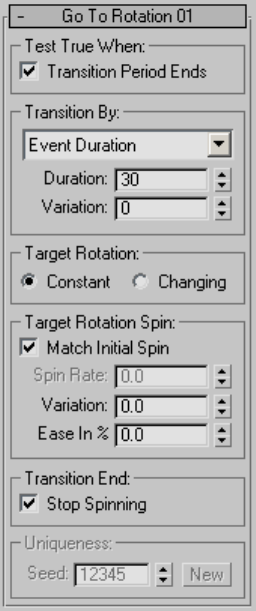
Interface
The user interface appears in the parameters panel, on the right side of the
Particle View dialog.
Test True When group
Transition Period Ends When on, the particles test True at the end of the
specified transition period, and become eligible for redirection to the next
event. When off, particles will not go to the next event, even if wired. Turn
off to disable the test aspect of Go To Rotation. Default=on.
Transition By group
Determines how the software applies the specified timing, defined by the Time
and Variation values. Default=Event Duration.
Particle Flow | 2905
The possible options are:
■Absolute Time Time refers to the overall time of the system. Each particle
will reach its target orientation at the frame number specified by Time.
■Particle Age Time refers to the time elapsed since the birth of the particle.
Each particle will reach its target orientation when its age reaches the value
specified by Time.
■Event Duration Time refers to the time elapsed since the particle entered
the current event. Each particle will reach its target orientation when it
has been in the current for the number of frames specified by Time.
Duration The number of frames particles should take to reach the target
orientation. Default=30.
Variation The number of frames by which Duration can vary randomly.
Default=0.
To obtain the actual time to the target orientation for each particle, the system
multiplies the Variation value by a random number between -1.0 and 1.0, and
then adds the result to the Duration value. For example, if Duration=60 and
Variation=20, then the time to target orientation for each particle would be
between 40 and 80 frames.
Target Rotation group
When you use an orientation-type operator with Go To Rotation, this setting
lets you determine whether the test sets the target orientation on a one-time
or ongoing basis. Default=Constant.
Constant Defines that the orientation-type operator sets a constant
orientation for a particle.
For example, when using a Rotation operator set to an orientation matrix
other than Speed Space Follow, the Go To Rotation operator would acquire
the target orientation only once, and then use it as its goal.
Changing Defines that the orientation-type operator sets a changing rotation
for a particle. At each frame the desirable final rotation may be different.
For example, if you use the test with a Rotation operator set to Speed Space
Follow, the test will adjust the particle rotation constantly to aim at the
changing final rotation.
2906 | Chapter 12 Space Warps and Particle Systems

Target Rotation Spin group
Defines the angular velocity for each particle when it reaches the target
orientation.
Match Initial Spin Sets the angular velocity at the end of the transition period
to the same as the angular velocity when particle enters the event.
NOTE The axis of rotation might still be different, because it is calculated on the
fly to let the particle come to the target orientation.
Spin Rate Defines each particle's angular velocity, in degrees per second,
when it reaches the target orientation. Available only when Match Initial Spin
is off. Default=0.0.
For a smooth transition to the target orientation, set to 0.0.
Variation Defines a random variation in the Spin Rate value when a particle
reaches the target orientation. Default=0.0.
To obtain the final angular velocity for each particle, the system multiplies
the Variation value by a random number between -1.0 and 1.0, and then adds
the result to the Spin Rate value. For example, if Spin Rate=6.0 and
Variation=1.0, then the final angular velocity for each particle would be
between 5.0 and 7.0 degrees per second.
Ease In % Defines a curve in achieving the final spin rate. Default=0.0
When set to 0.0, the test produces a linear interpolation between the initial
and final spin rate, and when set to 100.0, the final spin rate is achieved earlier.
For the smoothest approach to the target orientation, set Spin Rate and
Variation to 0.0, and Ease In to 100.0.
Transition End group
Stop Spinning When on, halts particle rotation when it reaches the target
orientation. Default=on.
Even with Spin Rate spinner set to 0.0, we recommend that you keep this
check box on to avoid slow spinning at the end, due to computational
averaging and marginal errors.
Uniqueness group
The Uniqueness setting enables randomization of the Variation options.
Seed Specifies a randomization value.
Particle Flow | 2907
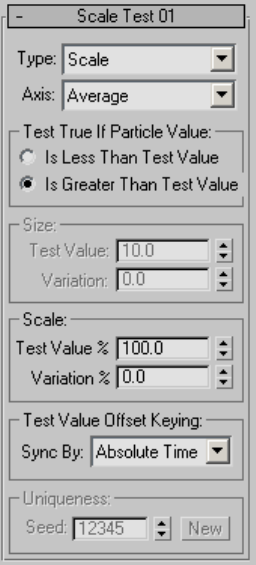
New Calculates a new seed using a randomization formula.
Scale Test
Particle View on page 2730 > Click Scale Test in an event or add Scale Test to
the particle system and then select it.
Scale Test lets the particle system check particle scaling, or particle size before
or after scaling, and branch accordingly. The test provides a variety of axis
options for measuring scale or size.
You can use this test to cause a change in behavior based on size. For example,
a bubble could grow to a certain size, and then pop. Or an object could shrink
in size until it falls under the influence of a force, like wind.
Interface
2908 | Chapter 12 Space Warps and Particle Systems

The user interface appears in the parameters panel, on the right side of the
Particle View dialog.
Type Choose the type of measurement to test. You can test actual scaling,
or the size before or after scaling. Default=Scale.
For example, if the X-axis size of a particle's bounding box starts out at 10
system units, and you then use the Scale operator to scale it by 150% on the
X axis, the pre-scale size is 10, and the post-scale size is 15. And, of course,
the scale is 150.
NOTE The software measures particle size based on each particle’s bounding-box
dimensions in the particle's local coordinate space. With the low-polygon Shape
options Tetra and Sphere, the result of this measurement might not be the same
as the Shape operator’s Size value.
■PreScale Size Tests the size before scaling.
■PostScale Size Tests the size after scaling.
■Scale Tests the scaling percentage.
Axis Choose the axis to measure. Default=Average.
■Average Obtains an average measurement by adding the sizes on all
three axes and then dividing by three.
■Minimum Uses the smallest dimension.
■Median Uses the middle dimension in order of size. For example, if the
particle dimensions are X=5, Y=6, Z=12, then the number compared to
Test Value would be 6.
■Maximum Uses the largest dimension.
■X/Y/Z Uses the specified dimension.
Test True if Particle Value Lets you specify whether the test passes particles
on to the next event if the speed test succeeds or fails. Available for all tests
except True When Accelerates/Decelerates. Default=Is Greater Than Test Value.
By default, Scale Test returns True if the value tested for exceeds the Test Value
quantity, but you can alternatively choose Is Less Than Test Value. For example,
if you set Type to Scale and set Test Value=150 and Variation=0, and choose
Is Less Than Test Value, a particle will move to the next event only when its
scaling factor is less than 150%.
Particle Flow | 2909
Size group
These settings are available when Type is set to PreScale Size or PostScale Size.
Test Value The specific size to test for. Default=10.0.
Variation The amount by which the value tested for can vary randomly.
Default=0.0.
To obtain the actual test value for each particle, the system multiplies the
Variation value by a random number between -1.0 and 1.0, and then adds the
result to the Test Value setting. For example, if Test Value=10 and Variation=5,
then the tested value for each particle would be between 5 and 15.
Scale group
These settings are available when Type is set to Scale.
Test Value The specific scaling factor to test for. Default=100%.
Variation The amount by which the value tested for can vary randomly.
Default=0.0%.
To obtain the actual test value for each particle, the system multiplies the
Variation value by a random number between -1.0 and 1.0, and then adds the
result to the Test Value setting. For example, if Test Value=100% and
Variation=10%, then the tested value for each particle would be between 90%
and 110%.
Test Value Offset Keying group
Sync By Choose the time frame to use when animating Test Value and
Variation:
■Absolute Time Any keys set for parameters are applied at the actual frames
for which they're set.
■Particle Age Any keys set for parameters are applied at the corresponding
frames of each particle's existence.
■Event Duration Any keys set for parameters are applied to each particle
starting when it first enters the event.
Uniqueness group
The Uniqueness setting enables randomization of the test value variation.
Available only when either Variation value exceeds 0.0.
2910 | Chapter 12 Space Warps and Particle Systems
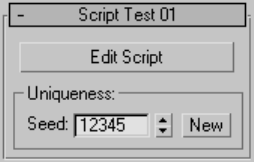
Seed Specifies a randomization value.
New Calculates a new seed using a randomization formula.
Script Test
Particle View on page 2730 > Click Script Test in an event or add a Script Test
operator to the particle system and then select it.
Script Test lets you test particle conditions using a MAXScript script. The script
can use any program functionality available to MAXScript.
The default test script tests for the presence of all particles within a spherical
volume of radius 20.
Interface
The user interface appears in the parameters panel, on the right side of the
Particle View dialog.
Edit Script Click this button to open the current script in a MAXScript Editor
window.
For detailed information about the MAXScript utility, open the MAXScript
Reference, available from Help menu > MAXScript Reference.
Uniqueness group
The Uniqueness setting provides a randomization seed that the script can use
or ignore.
Seed Specifies a randomization value.
New Calculates a new seed using a randomization formula.
Particle Flow | 2911
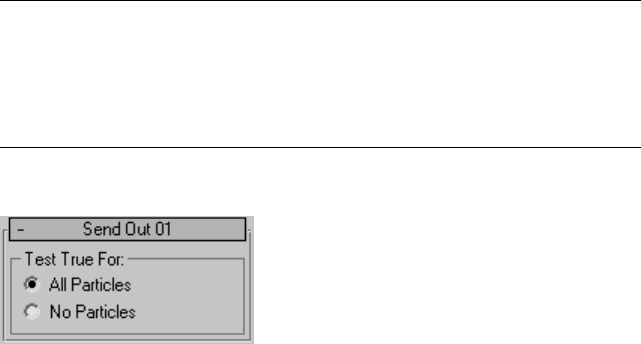
Send Out Test
Particle View on page 2730 > Click Send Out in an event or add Send Out to
the particle system and then select it.
The Send Out test simply sends all particles to the next event, or, conversely,
keeps all particles in the current event. Use Send Out when you simply want
to send particles to another event without any conditions.
TIP You can temporarily convert any test to Send Out. To specify that a test should
send all particles out without any conditions, click the left side of its icon in Particle
view; the icon changes to a green light bulb to indicate that all particles
automatically test True. Or, if you click the right side of the icon, it changes to a
red light bulb, indicating that all particles test False and thus will stay in the current
event. To revert to the test's original function, click its icon again.
Interface
The user interface appears in the parameters panel, on the right side of the
Particle View dialog.
Test True For Lets you specify whether the test passes all particles on to the
next event or keeps them in the current event. Default=All Particles.
■All Particles All particles are passed on to the next event.
■No Particles All particles are retained in the current event.
Spawn Test
Particle View on page 2730 > Click Spawn in an event or add Spawn to the
particle system and then select it.
Spawn creates new particles from existing ones. Each spawned particle is born
at the same location as its parent, and has the same orientation and shape.
Spawn can give the spawned particles a different speed and scaling factor. If
2912 | Chapter 12 Space Warps and Particle Systems
you wire the Spawn test to another event, spawned particles are sent to that
event, where you can specify different properties for the new particles.
Spawn is a test only in that it sends the spawned particles to another event
(if wired); it doesn't actually test any properties. All particles that encounter
Spawn are immediately affected by it. Thus, if you want particles to spawn
based on the results of a test, use a different test that branches to an event
containing the Spawn. In such a case, you might want to then send the
spawned particles to yet another event, or the particles will continually
respawn. Alternatively, to spawn particles after a collision, use Collision Spawn
Test on page 2885 .
See also:
■Collision Spawn Test on page 2885
Particle Flow | 2913
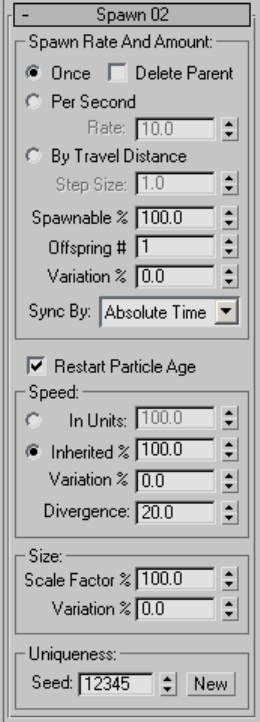
Interface
The user interface appears in the parameters panel, on the right side of the
Particle View dialog.
In the context of Spawn, a parent is the original particle from which new
particles are spawned.
Spawn Rate And Amount group
Use these settings to specify how often particles are to spawn, the measurement
system to use, and other values related to how many particles are spawned.
2914 | Chapter 12 Space Warps and Particle Systems
Once Particles spawn one time only. For each existing particle, one new one
is born.
Delete Parent When on, deletes each original particle from which a new
one is spawned. Available only with the Once option.
Per Second Lets you specify a number of particles to spawn every second.
For example, if you use the default Rate setting of 10.0, at 30 fps a new particle
is born every three frames.
Rate The number of particles to spawn per second. Available only with the
Per Second option.
By Travel Distance Lets you spawn new particles at regular intervals over
the path of a moving parent particle.
Step Size The system spawns a new particle every time the parent moves
this distance, in system units.
Spawnable The percentage of particles in the current event that will spawn
new particles. This is determined once for each particle, when it enters the
event. However, the parameter is animatable. Default=100.0.
For values other than 100.0, Spawnable uses a randomized selection process,
which is affected by the Uniqueness Seed value. For example, with five parent
particles, Offspring #=1, and Spawnable=80.0, you might get any number of
spawned particles between two and five. The average per spawning would be
four, however.
Offspring # The number of new particles the system creates from each parent
particle for each spawning event. Default=1.
Variation The amount by which the Offspring # value can vary randomly.
Default=0.0.
To obtain the actual test value for each particle, the system multiplies the
Variation value by a random number between -1.0 and 1.0, and then applies
the result as a percentage of the Offspring # setting. For example, if Offspring
#=20 and Variation=10, then the actual number of offspring for each particle
would be between 18 and 22.
Sync By Choose the time frame to use when animating Rate, Step Size,
Offspring #, and Variation:
■Absolute Time Any keys set for parameters are applied at the actual frames
for which they're set.
■Particle Age Any keys set for parameters are applied at the corresponding
frames of each particle's existence.
Particle Flow | 2915
■Event Duration Any keys set for parameters are applied to each particle
starting when it first enters the event.
Restart Particle Age When on, sets the age of each newly spawned particle
at 0. When off, each spawned particle inherits its parent's age. Default=on.
Speed group
Lets you specify the speed of spawned particles in absolute terms or relative
to the parents' speed, with optional random variation. The direction of a
spawned particle is always in relation to that of its parent, but you can set a
Divergence so they eventually spread out. Default=Inherited.
In Units Choose this to specify the speed of spawned particles in system
units per second. Default=100.0.
A positive value inherits the parent's direction; a negative value reverses it.
Inherited Choose this to specify each spawned particle's speed as a percentage
of its parent's speed. Default=100.0
A positive value inherits the parent's direction; a negative value reverses it.
Variation The amount by which a spawned particle's speed can vary
randomly. Default=0.0.
To obtain the actual speed for each spawned particle, the system multiplies
the Variation value by a random number between -1.0 and 1.0, and then adds
the result to the particle's speed as specified or inherited. For example, if a
particle's speed is 100 units/second and Variation=20, then the tested value
for each particle would be between 80 and 120 units/second.
Divergence When on, spreads out the stream of spawned particles. Use the
numeric setting to define the extent of the divergence in degrees. Range=0 to
180. Default=0.
Size group
Scale Factor The amount of uniform scaling to apply to each spawned
particle, as a percentage of its parent's size. Default=100.0.
Variation The amount by which a spawned particle's scale can vary randomly.
Default=0.0.
To obtain the actual scaling for each spawned particle, the system multiplies
the Variation value by a random number between -1.0 and 1.0, and then adds
the result to the Scale Factor value. For example, if Scale Factor=100 and
2916 | Chapter 12 Space Warps and Particle Systems
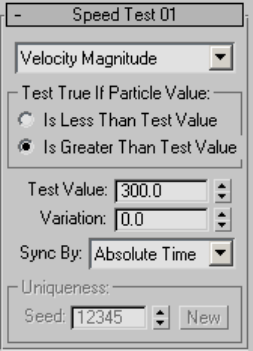
Variation=20, then each spawned particle would be between 80 and 120
percent of its parent's size.
Uniqueness group
The Uniqueness setting enables randomization of the Spawnable result, when
less than 100.0, as well as of the Variation values.
Seed Specifies a randomization value.
New Calculates a new seed using a randomization formula.
Speed Test
Particle View on page 2730 > Click Speed Test in an event or add Speed Test to
the particle system and then select it.
Speed Test lets the particle system check particle speed, acceleration, or the
rate of circular travel, and branch accordingly. The test provides a number of
variants that let you test speed or acceleration on specific axes, or simply
whether the particle is accelerating or decelerating.
Interface
The user interface appears in the parameters panel, on the right side of the
Particle View dialog.
Particle Flow | 2917

The first interface element is a drop-down list that lets you choose the type
of measurement to test:
■Velocity Magnitude Tests the particle velocity, in system units per second,
without consideration of direction. This is the default test type.
■Velocity X/Y/Z Tests the particle velocity on the specified axis, in system
units per second, using the world coordinate system.
An example of this option would be with fireworks: As the particles move
upward, their velocity on the world Z axis is positive. When the reach the
top of their trajectory and begin to move downward, their velocity on the
world Z axis slows to 0, and then becomes negative. If you choose Velocity
Z and Is Less Than Test Value, and set Test Value to 0.0, you can send
particles to another event at the moment they begin to move downward.
■Acceleration Magnitude Tests the particle acceleration (change in
velocity), in system units per second per second, without respect to
direction.
■Acceleration X/Y/Z Tests the particle acceleration (change in velocity)
on the specified axis, in system units per second per second, using the
world coordinate system.
■Steering Rate Tests the circular component of particle travel in degrees
per second, without consideration of rotation or spinning.
For example, if a particle travels along a parabolic path, its motion has
both linear and circular components. The circular component is greatest
at the top of the parabola. If a particle travels in a full circle in one second,
the rate is 360; if it travels in a half circle, the rate is 180.
Potential usage: When a particle is forced to turn too sharply, it might
explode or change its type of movement. For example, missiles chase a jet
fighter, which maneuvers to elude the missiles. The missiles are forced to
change their course rapidly, but the missile construction cannot stand the
fast change in steering, so the missiles blow up or disintegrate.
TIP You can test steering rate by setting the particle speed with Speed By
Icon on page 2796 , and linking the Speed By Icon operator icon to a circular
path.
■True When Accelerates Returns a True value when the particle velocity
is increasing in value.
■True When Decelerates Returns a True value when the particle velocity
is decreasing in value.
2918 | Chapter 12 Space Warps and Particle Systems
Test True if Particle Value Lets you specify whether the test passes particles
on to the next event if the speed test succeeds or fails. Available for all tests
except True When Accelerates/Decelerates. Default=Is Greater Than Test Value.
By default, Speed Test returns True if the value tested for exceeds the Test
Value quantity, but you can choose Is Less Than Test Value as well. For
example, if you use the Velocity Magnitude test type and set Test Value=200
and Variation=0, and choose Is Less Than Test Value, then particles will move
to the next event only when they travel faster than 200 units per second. Any
particles traveling 200 units per second or slower stay in the current event
unless they later exceed that speed or another test returns True.
Test Value The specific speed or acceleration to test for. The unit of
measurement depends on the type of test; see above. Default=300.0.
Variation The amount by which value tested for can vary randomly.
Default=0.0.
To obtain the actual test value for each particle, the system multiplies the
Variation value by a random number between -1.0 and 1.0, and then adds the
result to the Test Value setting. For example, if Test Value=300 and
Variation=10, then tested value for each particle would be between 290 and
310.
Sync By Choose the time frame to use when animating Test Value and
Variation. For further information, see Animation Offset Keying group on
page 2790 .
■Absolute Time Any keys set for parameters are applied at the actual frames
for which they're set.
■Particle Age Any keys set for parameters are applied at the corresponding
frames of each particle's existence.
■Event Duration Any keys set for parameters are applied to each particle
starting when it first enters the event.
Uniqueness group
The Uniqueness setting enables randomization of the test value variation.
Seed Specifies a randomization value.
New Calculates a new seed using a randomization formula.
Particle Flow | 2919
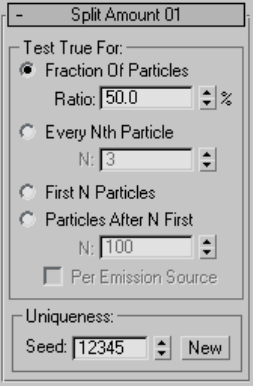
Split Amount Test
Particle View on page 2730 > Click Split Amount in an event or add Split Amount
to the particle system and then select it.
The Split Amount test lets you send a specific number of particles to the next
event, keeping all remaining particles in the current event. You can split the
particle stream by a specific number or percentage, or by every Nth particle.
With a specific number of particles, the splitting takes place once per event,
but you can animate the percentage and “every Nth” values to vary the amount
of split-off particles over time.
Interface
The user interface appears in the parameters panel, on the right side of the
Particle View dialog.
Test True For group
Lets you choose how to split the particle stream. Default=Fraction Of Particles,
50%.
Fraction Of Particles Split the particle stream on a percentage basis, specified
with the Ratio value. With Ratio greater than 0.0, whether a particular particle
is split off depends on a randomization factor; change this with the Uniqueness
Seed value.
2920 | Chapter 12 Space Warps and Particle Systems
Ratio Specify the percentage of particles that will test True. Animatable.
Default=50.0.
Available only with the Fraction Of Particles option.
Every Nth Particle Splits off a regular sample of particles.
NSpecify how often to split off a particle. Animatable. Default=3.
For example, enter 8 to split off every eighth particle.
Available only with the Every Nth Particle option.
First N Particles Splits off the number of particles specified as the N value
(below), starting with the first particle to enter the event, and retains the rest.
Particles After N First Splits off all particles starting with the first one after
N particles, as specified with the N parameter (below). All particles starting
with the first to enter the event up to N are retained in the event.
NSpecify the number of particles to split off, with First N Particles, or to
retain in the event, with Particles After N First.
Available only with the First N Particles or the Particles After N First option.
Per Emission Source When on, the software applies the N value for the
options First N Particles and Particles After N First separately for each emission
source.
Use this option with multiple Particle Flow sources converging into a single
Split Amount test.
Uniqueness group
The Uniqueness setting enables randomization of particle retention with the
Fraction Of Particles option.
Seed Specifies a randomization value.
New Calculates a new seed using a randomization formula.
Split Selected Test
Particle View on page 2730 > Click Split Selected in an event or add Split Selected
to the particle system and then select it.
The Split Selected test lets you split the particle stream based on particles'
selection status. For information about selecting particles, see Selection rollout
on page 2753 .
Particle Flow | 2921
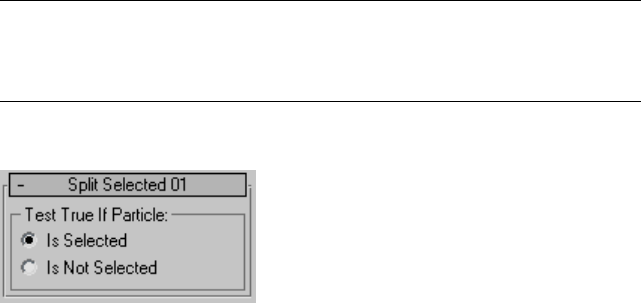
NOTE This test considers only particles selected at the Particle sub-object level.
To use all particles in an event at a specific frame, go to that frame, go to the Event
sub-object level, and highlight the event. Then go to the Particle sub-object level,
and on the Selection rollout, click Get From Event Level.
Interface
The user interface appears in the parameters panel, on the right side of the
Particle View dialog.
Test True If Particle group
Lets you choose how to split the particle stream. Default=Is Selected.
Is Selected All selected particles are eligible for redirection to another event.
Is Not Selected All non-selected particles are eligible for redirection to another
event.
Split Source Test
Particle View on page 2730 > Click Split Source in an event or add Split Source
to the particle system and then select it.
The Split Source test lets you split the particle stream based on particles' origin.
You can specify that particles from one or more specific Particle Flow sources
should or should not be eligible for redirection to the next event.
2922 | Chapter 12 Space Warps and Particle Systems
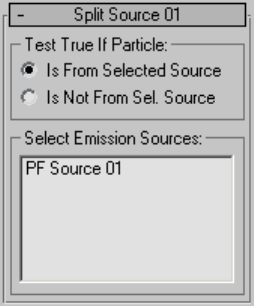
Interface
The user interface appears in the parameters panel, on the right side of the
Particle View dialog.
Test True If Particle group
Lets you choose how to split the particle stream. Default=Is From Selected
Source.
Is From Selected Source All particles from sources highlighted in the Selected
Emission Sources list are eligible for redirection to another event.
Is Not From Sel(ected) Source All particles from sources not highlighted in
the Selected Emission Sources list are eligible for redirection to another event.
Selected Emission Sources Lists all emission sources in the system. Highlight
the sources to be considered by the test.
Non-Event-Driven Particle Systems
Create panel > Geometry > Particle Systems
Create menu > Particles
Non-Event-Driven Particle Systems | 2923
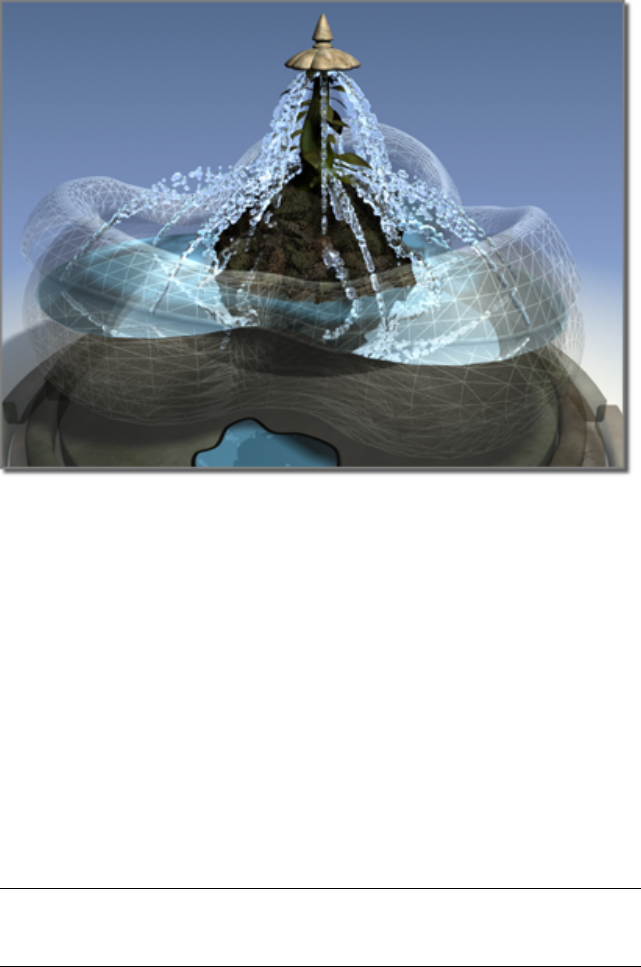
Fountain spray created as a particle system
Non-event-driven particle systems provide relatively simple, straightforward
methods for generating particle sub-objects over time for the purpose of
simulating snow, rain, dust, and so on. You use particle systems primarily in
animations.
3ds Max provides six built-in, non-event-driven particle systems:
Spray Particle System on page 2938
Snow Particle System on page 2942
Super Spray Particle System on page 2947
Blizzard Particle System on page 2951
PArray Particle System on page 2964
PCloud Particle System on page 2956
NOTE You can take advantage of the AutoGrid feature to orient and position new
particle systems with respect to existing objects. For details, see AutoGrid on
page 2513 .
2924 | Chapter 12 Space Warps and Particle Systems
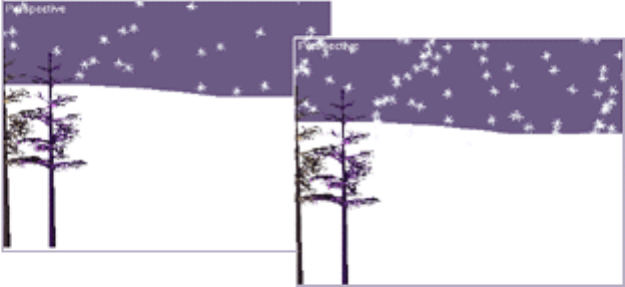
See also:
■Particle System Usage on page 2926
■Creating a Particle Emitter on page 2928
■Particle Flow on page 2713
Interface
Snowstorm created as a particle system
This topic describes only the general properties of particle systems. Other
plug-in particle systems might be available in your configuration.
The built-in particle systems share these controls:
Emitter Specifies where in the scene the particles are generated. The emitter
is the particle system's main sub-object. It doesn't render. Particles appear on
the surface of the emitter and fall (or drift, drop, flurry, spray) from the emitter
in a particular direction.
Timing The timing parameters control the dynamics of particles in the
system. They specify how quickly particles appear, how quickly they disappear,
whether the emission rate is constant, and so on.
Particle-specific parameters These parameters are specific to the kind of
particle system. Examples are particle size and speed.
Rendering properties These parameters are also specific to the kind of particle
system. There are options for displaying particles in viewports and rendering
them in scenes and animations. Particles do not necessarily appear the same
in renderings as they do in viewports.
Non-Event-Driven Particle Systems | 2925

You can modify and animate particle system parameters. You can also affect
particle system behavior with space warps on page 2603 . In addition, you can
deform particle systems with the Mesher compound object on page 767 .
NOTE Particles can participate in dynamics simulations.
Particle System Usage
You create particle systems when you want to model an object or effect that
can best be described as a large collection of similar objects behaving in a
similar fashion. Obvious examples of such effects include rain and snow, but
other equally valid examples include water, smoke, ants, and even crowds of
people.
On the Create panel, click Spray, Snow, Super Spray, Blizzard, PArray, or PCloud
to create a particle system. Spray and Snow exist primarily for compatibility
with earlier releases of 3ds Max, and are superseded by Super Spray and
Blizzard.
To create a particle system, first choose Create menu > Particles > Spray or
Snow.
These are the basic steps for creating a particle system:
1Create a particle emitter. All particle systems require an emitter. Some
particle systems use the particle system icon as the emitter while others
use an object you select from the scene as the emitter.
2Determine the number of particles. You set parameters such as birth rate
and life span to control how many particles can exist at any given time.
3Set particle shape and size. You can select from many standard particle
types (including metaballs) or you can select an object to be emitted as
a particle.
4Set initial particle motion. You can set the speed, direction, rotation, and
randomness of particles as they leave the emitter. Particles can also be
affected by animation of the emitter.
5Modify particle motion. You can further modify the motion of particles
after they leave the emitter by binding the particle system to a space warp
in the Forces group, such as Path Follow, or make them bounce off a
deflector in the Deflectors space warp group, such as UDeflector.
2926 | Chapter 12 Space Warps and Particle Systems

IMPORTANT When you use forces and deflectors together, always bind the
forces before the deflectors.
TIP If the particles don't follow the emitter after it's moved, then change any
Path Follow parameter on page 2635 . The motion will be applied to the
particles.
Rain and Snow
Create rain and snow using Super Spray on page 2947 and Blizzard on page
2951 . These particle systems are optimized for droplet (Super Spray) and
tumbling flake (Blizzard) effects. Add space warps such as Wind on page 2642
to create spring rains or winter storms.
Bubbles
Create bubbles by using the Bubble Motion options of Super Spray on page
2947 . If you require good rendering speed, consider using constant or tetra
particles. If you require bubble detail, consider using opacity-mapped facing
particles, instanced spheres, or metaparticles.
Flowing Water
You generate flowing liquid effects by setting Super Spray on page 2947 to
generate closely packed metaparticles. The metaparticles blob together forming
a stream. Add a Path Follow on page 2635 space warp to send the stream down
a trough.
Explosions
Particle Array (PArray) on page 2964 uses another object as its particle emitter.
You can set the particle type to use fragments of the emitter object to simulate
the object exploding.
Volume Effects
Particle Cloud (PCloud) on page 2956 constrains its particles within a specified
volume. You can use Particle Cloud to generate bubbles in a glass of soda, or
bees buzzing inside a jar.
Non-Event-Driven Particle Systems | 2927
Crowds
Super Spray on page 2947 , Blizzard on page 2951 , Particle Array on page 2964 ,
and Particle Cloud on page 2956 can use instanced geometry as their particle
type. You can create a stream of ants, a flock of birds, or a cloud of dandelion
seeds using instanced geometry particles.
Creating a Particle Emitter
After you choose a particle system type to add, you create the particle system
icon in the scene. The icon serves different purposes depending on the type
of particle system.
As an emitter: The icon defines the starting location and direction of the
particles. Spray, Snow, Super Spray, Blizzard, and Particle Cloud use the icon
as the particle emitter.
As a placeholder: The icon serves only to hold the parameters for the particle
system. The particles are emitted from another selected object. Particle Array
and Particle Cloud use the icon as a placeholder.
You can choose whether Particle Cloud uses its icon or another selected object
as the emitter.
Procedures
To create emitter icons:
■Drag in a viewport to set the size and orientation of the particle emitter
icon for Spray, Snow, Super Spray, Blizzard, and Particle Cloud.
Spray, Snow, Blizzard, and Particle Cloud use the icon size as the area of
particle emission. Super Spray emits particles from its center regardless of
its icon size.
All particle systems align the particle direction with the Z axis of the
creation grid.
To create placeholder icons:
1Drag in a viewport to set the size of the placeholder icon for Particle Array
and Particle Cloud.
The size and location of the particle system icon has no effect on the
particles.
2928 | Chapter 12 Space Warps and Particle Systems
2After placing the particle system icon, click Pick Object on the Basic
Parameters rollout to select the object to use as the particle emitter.
Using Materials with Particle Array
The material that appears on the particles comes from one of three places:
■The particle system itself
■The material assigned to the distribution object (PArray only)
■The material assigned to the instanced objects
Non-Event-Driven Particle Systems | 2929
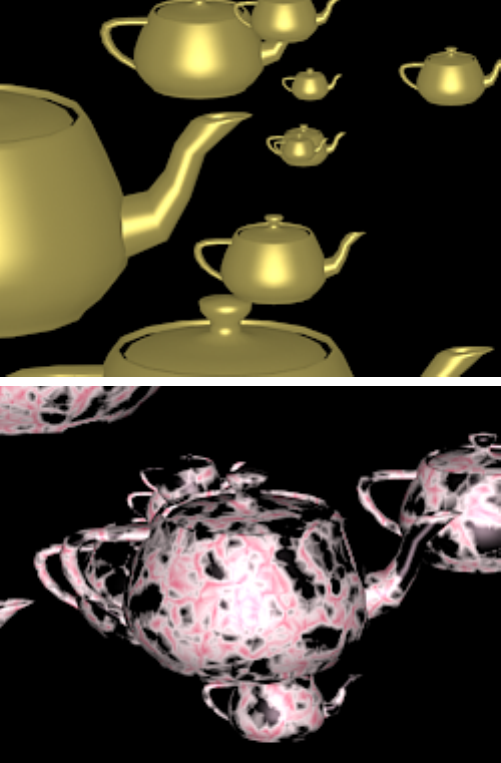
2930 | Chapter 12 Space Warps and Particle Systems
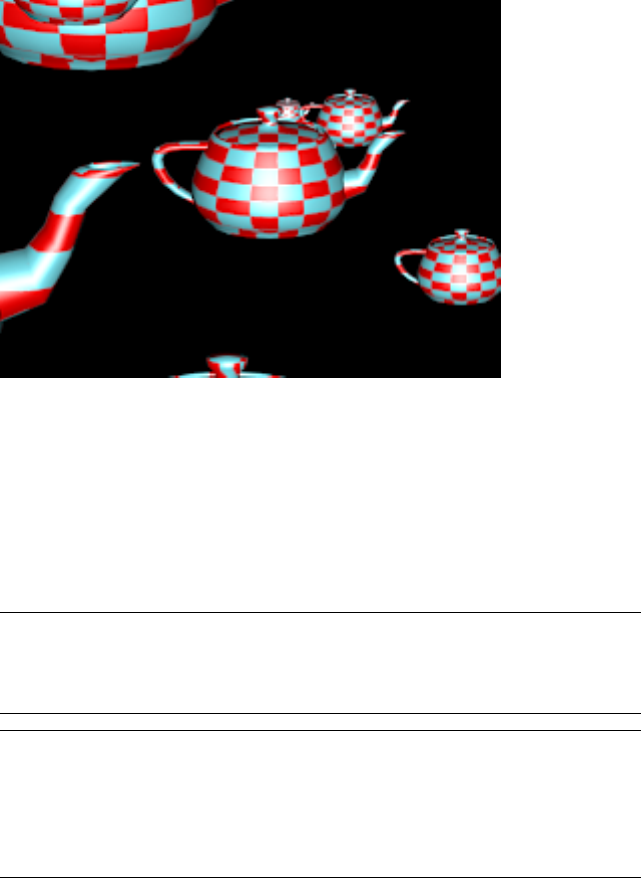
Particles with various materials assigned to them
You make this choice in the Material Mapping and Source group near the
bottom of the Particle Type rollout. Choose Icon to use the material assigned
to the particle system, choose Picked Emitter to use the material assigned to
the distribution object, or choose Instanced Geometry to use the material
assigned to the instanced objects. Note that this third option is available only
when Instanced Geometry is the current particle type (selected in the Particle
Types group at the top of the Particle Type rollout).
NOTE SuperSpray and Blizzard don't have distribution objects. PCloud has a
distribution object but you can't get the material from it. In these cases, a radio
button lets you use the material from the instanced geometry. Only PArray lets
you get the material from the distribution object.
IMPORTANT A particle-system object, like any other object, can carry only a single
material at any time. Thus, if you choose either Picked Emitter or Instanced
Geometry, an instance of the chosen material is actually copied to the particle
system, overwriting the material assigned to the emitter. If you want to restore
the emitter material, choose Icon, and then reassign the material from the Material
Editor or the Browser.
No matter what choice you make, if the material used is not mapped, then
all particles take on the surface properties of the material, regardless of which
object is used as the source of the material.
Non-Event-Driven Particle Systems | 2931

Achieving Particle Motion Blur
Particle motion blur is actually the result of varying the opacity and the length
of particles based on their speed. To accomplish this requires coordination
between material assignment and the settings in the particle systems. Follow
these instructions:
■Use the Particle MBlur map on page 5729 in the material that you assigned
to the particles. For best results, assign it as an opacity map.
■Make sure that the particle system, PArray, PCloud, and Super Spray, or
Spray, supports the Particle MBlur map.
■Choose Rotation and Collision rollout > Spin Axis Controls group >
Direction of Travel/Mblur option.
■In this same group, set the Stretch spinner greater than 0 to stretch the
particles as a percent of their length based on the particle Speed setting.
■Use the correct type of particle. MBlur works on all particle types except
Constant and Facing.
NOTE Instanced objects with multi/sub-object materials cannot be image
motion blurred.
Using Mapped Materials with Particle Systems
Mapped materials affect particles differently, depending on the source of the
material.
2932 | Chapter 12 Space Warps and Particle Systems
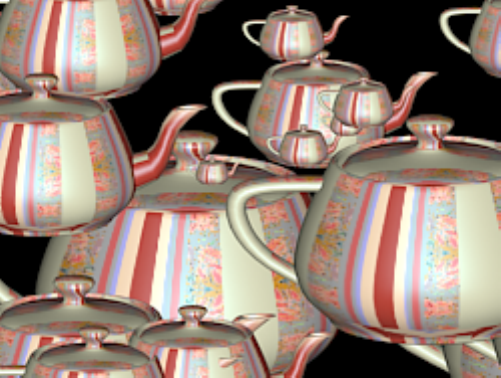
Particles with a diffuse-mapped material
When you choose Icon, the mapping coordinates of the material are applied
across the V (vertical) axis, from V=0 (the bottom edge of the map) to V=1
(the top edge of the map). The bottom edge of the map is applied at the birth
of the particle, and the top edge at either the death of the particle (if Time is
on) or the distance of the particle at its death (if Distance is on).
The Time spinner specifies the number of frames from birth that it takes to
complete one mapping of a particle. Thus, if set to 15, the particle uses the
bottom edge of the map at its birth, and moves through to the top edge of
the map at frame 15.
The Distance spinner specifies the distance, in units, from birth that it takes
to complete one mapping of a particle. Thus, if set to 50, as the particle moves
along the normal vector, it displays the bottom edge of the map at birth, and
the top edge at 50 units along the normal vector.
The one exception to this is when you use the Tetra particle type. In this case,
each particle is always constantly mapped with V=0 at the head and V=1 at
the tail.
When you choose Picked Emitter, the particles take on the color of the object
at the point at which they're created. If the mapped surface is yellow where
the particle emerges, then the particle is yellow.
Again, Tetra particles are an exception and the distribution-object material is
mapped from head to tail.
Non-Event-Driven Particle Systems | 2933
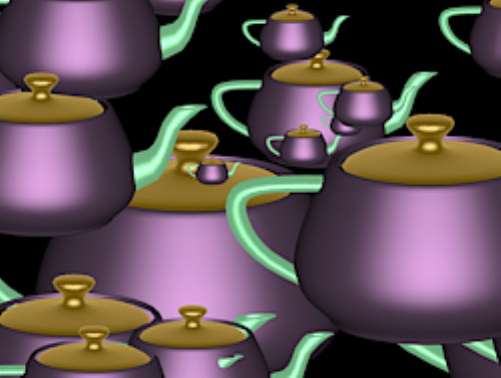
Fragment particles use the same technique, with additional options when the
Thickness setting is greater than 0.
When Thickness is 0, all faces in the fragment are mapped the same as the
portion of the object surface from which they're derived.
When Thickness is greater than 0, the outer faces of the fragment copy the
surface of the distribution object, and are assigned the material ID specified
in the Outside ID spinner in the Particle Type rollout > Fragment Materials
group. The thickness edges use the Edge ID number, and the inner faces use
Backside ID. Thus, by assigning a multi/sub-object material to the object-based
emitter, you can specify a different material for the outer fragment surfaces,
the edges, and the inner surfaces. Note that the Outside ID spinner defaults
to a value of 0, which means "use whatever material is currently assigned."
Change this to a specific sub-material number to assign a sub-material to the
outside edges of the fragments.
Using Multi/Sub-Object Materials with Particle
Systems
Particles with a Multi/Sub-Object material
2934 | Chapter 12 Space Warps and Particle Systems

If the assigned material is a Multi/Sub-Object material, particles are affected
in the following ways, depending on the source of the material:
■Icon: In most cases, each particle, at its birth, is assigned a different
sub-material, cycling through each available sub-material. For example, if
there are only three sub-materials, the first particle receives sub-material
#1, the second #2, the third #3, the fourth #1, and so on. The exceptions
to this are as follows:
■MetaParticles use only the first sub-material.
■Object fragments are born at once, so all of them use only the first
sub-material.
■Picked Emitter: When used with object fragments as particles, each particle
uses the three ID numbers in the Fragment Materials group. If this source
is used with the other particle types, the particles are assigned sub-materials
in the same way as when Icon is chosen.
■Instanced Geometry: When used with Instanced Geometry particles, each
particle is assigned a sub-material in exactly the same way as the source
object, so each particle looks just like the source object. When used with
other particle types, the particles are assigned sub-materials in the same
way as when Icon is chosen.
NOTE Instanced objects with Multi/Sub-Object materials cannot be image
motion blurred.
Using Spawned Particles
The examples in this topic start you out with a very simple spawning using
the Super Spray particle system.
Example: Setting up the particle system:
1In the Perspective viewport, create a pyramid that's 5 units in all
dimensions.
2Create a cylinder with a radius and height of 3, and 6 sides.
3In the center of the Perspective viewport, create a Super Spray emitter.
4Set Speed in the Particle Motion group (Particle Generation rollout) to
3.0.
Non-Event-Driven Particle Systems | 2935
5On the Particle Type rollout, choose Instanced Geometry, then in the
Instancing Parameters group click Pick Object, and select the pyramid.
6In the Viewport Display group of the Basic Parameters rollout, choose
Mesh and set the Percentage of Particles to 100.
7On the Particle Generation rollout, choose Use Rate, and set the spinner
to 1.
8Set Emit Start and Emit Stop to 0, set Display Until to 100, set Life to 10,
and leave Variation at 0.
9Under Particle Size, set Grow For and Fade For to 0.
10 Drag the time slider between frames 0 and 15.
A single pyramid particle emerges from the emitter, moves up, and then
dies and disappears at frame 10.
Example: Adding spawning effects:
1On the Particle Spawn rollout, choose Spawn on Death.
2Leave Spawns spinner at 1, and set the Multiplier to 2.
3Set the Direction Chaos spinner to 50.
4Drag the time slider slowly over frames 8 to 25 (approximately).
At frame 10, two pyramids appear at the death of the original particle
(because of the Multiplier setting), and move off in different directions
(because of the Direction Chaos setting). All particles die after frame 20
because only one generation of spawned particles is specified.
5Set Spawns to 4, and the Multiplier to 4.
6Drag the time slider over frames 8 to 50.
With each spawned generation the particles increase exponentially.
Example: To mutate the objects:
1In the Object Mutation Queue group, click Pick Object, and then select
the cylinder.
The name of the cylinder appears in the list window.
2Click Pick Object and select the pyramid. Then click Pick Object again,
and select the cylinder. Your list now reads: Cylinder01, Pyramid01,
Cylinder01.
2936 | Chapter 12 Space Warps and Particle Systems
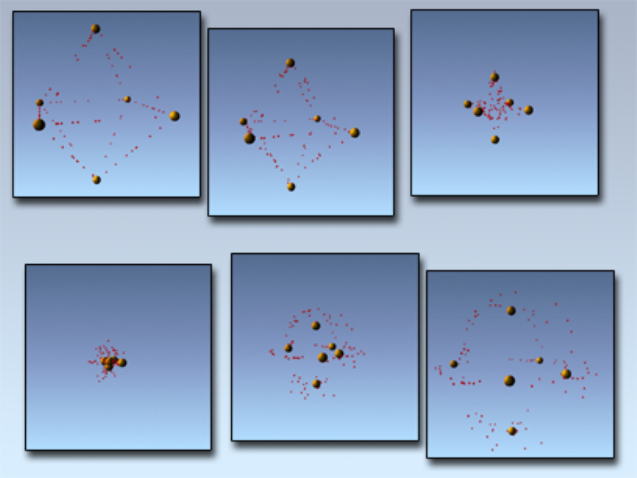
3Drag the time slider over frames 0 to 50.
The pyramid appears over frames 0 to 10, then changes to four cylinders
at frame 11, then 16 pyramids at the next spawning, and so on.
Using Interparticle Collision
Particles colliding and then rebounding
You can set up particles to detect collisions with each other. This can be useful
when the particles are meant to model solid objects such as marbles.
Procedures
Example: To create particles that collide with each other:
1Create a Super Spray particle emitter, and place a Deflector space warp
on page 2675 a short distance from it with the surface of the deflector
perpendicular to the stream of the particles. Bind the deflector to the
Super Spray.
Non-Event-Driven Particle Systems | 2937

2Set the Super Spray values as follows:
■Off Axis: 1, Spread: 1, Off Plane: 180, Spread: 180
■Mesh: chosen, Percent of Particles: 100
■Particle Quantity: Use Rate chosen and set to: 1
■Speed: 3, Variation: 100%
■Emit Start: 0, Emit Stop: 5, Display Until: 100, Life: 100
■Size: 4.0, Grow For: 0, Fade For: 0
■Particle Type: Sphere
3Drag the time slider so you can see the particle spheres bounce off the
deflector. Note that the rebounding particles move through each other.
4On the Rotation & Collision rollout, turn on Enable in the Interparticle
Collisions group. View the animation again. This time, the particles
bounce off each other.
TIP InterParticle Collisions, Deflector Binding, and Bubble Noise do not get
along well together. Particles may leak through the deflector when these
three are used together. Instead of bubble motion use animated mapping.
Use facing particles with an animated map of a bubble, where the bubble is
smaller than the map size. The bubble is animated moving around the map.
This simulates bubble motion at the map level.
Spray Particle System
Create panel > Geometry button > Choose Particle Systems from the drop-down
list. > Object Type rollout > Spray
Create menu > Particles > Spray
Spray simulates water drops such as rain, a fountain, the spray from a garden
hose, and so on.
2938 | Chapter 12 Space Warps and Particle Systems
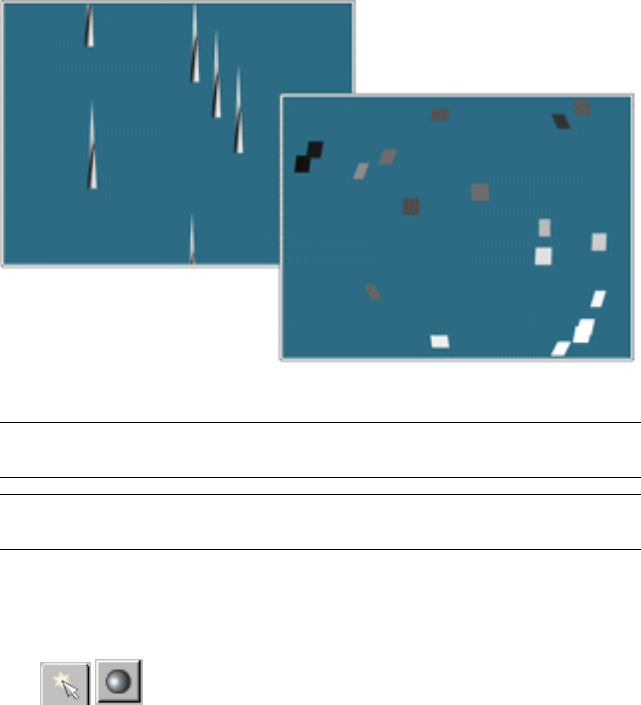
Kinds of Spray
NOTE SuperSpray on page 2947 is a more powerful and advanced version of
Spray. It provides all the functionality of Spray, plus additional features.
TIP To animate particles following a path through space, use the Path Follow
space warp on page 2635 .
Procedures
To create spray:
1 On the Create panel, make sure the Geometry button is
active and Particle Systems is chosen in the object category list, then click
Spray.
2Drag in a viewport to create the Spray emitter; see Creating a Particle
Emitter on page 2928 .
The emitter's direction vector points in the negative Z direction of the
active construction plane. For example, if you create the emitter in the
Top viewport, the particles will move downward in the Front and Left
viewports.
Non-Event-Driven Particle Systems | 2939
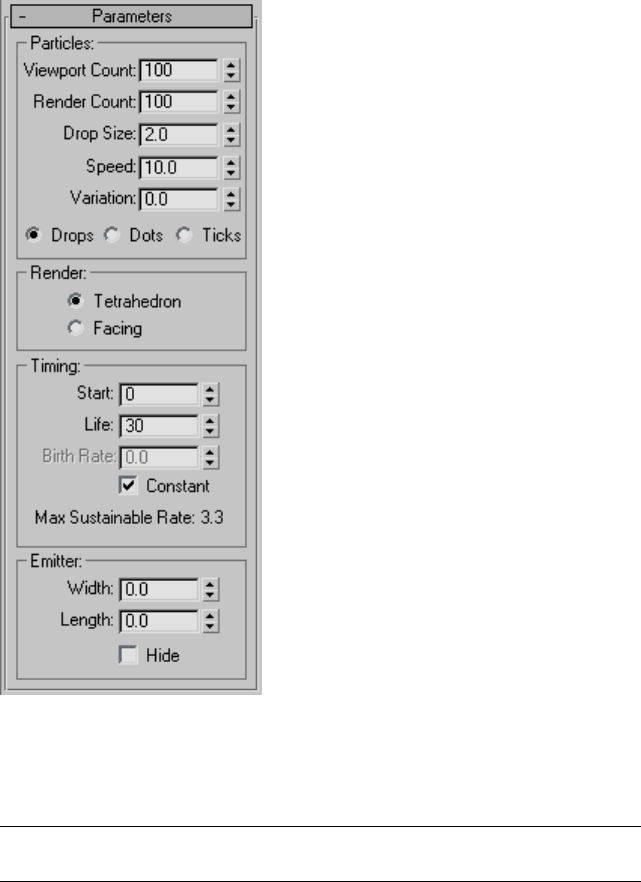
Interface
Particles group
Viewport Count Maximum number of particles displayed in viewports at
any given frame.
TIP Setting the viewport count less than the render count can improve viewport
performance.
2940 | Chapter 12 Space Warps and Particle Systems

Render Count Maximum number of particles that can appear in a single
frame when you render it. Works in combination with the particle system's
timing parameters.
■When the number of particles reaches the Render Count value, particle
creation is suspended until some particles die.
■When enough particles die, particle creation resumes until Render Count
is reached again.
Drop Size Size of a particle in the active units.
Speed Initial velocity of each particle as it leaves the emitter. Particles travel
at this speed unless they are affected by a particle system space warp.
Variation Varies the initial speed and direction of particles. The greater the
Variation, the stronger and broader the spray.
Drops, Dots, or Ticks Choose how particles are displayed in viewports. The
display setting does not affect how particles are rendered. Drops are streaks
that appear like raindrops, dots are points, ticks are small plus signs.
Render group
Tetrahedron Particles are rendered as long tetrahedrons, with the length
you specify in the Drop Size parameter. Tetrahedron is the default setting for
rendering. It provides a basic simulation of water drops.
Facing Particles are rendered as square faces whose width and height equals
the Drop Size. Facing particles always face the camera (or the user's perspective).
They are provided especially for use with material maps. Use with an
appropriate opacity map for bubbles or snowflakes.
NOTE Facing works correctly only in a perspective or camera view.
Timing group
Timing parameters control the "birth and death" rates of emitted particles.
At the bottom of the Timing group is a line that displays the maximum
sustainable rate. This value is based on the Render Count and the lifetime of
each particle. To be precise:
maximum sustainable rate=Render Count/Life
Because the number of particles in a frame never exceeds Render Count, if
the Birth Rate exceeds the maximum rate, the system will run out of particles,
Non-Event-Driven Particle Systems | 2941
pause until some die off, and then start again, generating particles in bursts
or spurts.
Start Number of the first frame where particles appear.
Life The lifetime of each particle, in number of frames.
Birth Rate The number of new particles born per frame.
If this is less than or equal to the maximum sustainable rate, the particle
system generates an even flow of particles. If it is greater than the maximum
rate, the particle system generates particles in bursts.
You can animate the Birth Rate parameter.
Constant When on, Birth Rate is unavailable and the birth rate used equals
the maximum sustainable rate. When off, Birth Rate is available. Default=on.
Turning Constant off does not mean that the birth rate varies automatically;
the birth rate remains constant unless you animate the Birth Rate parameter.
Emitter group
The emitter specifies the area where particles appear in the scene. It has a
geometry you can display in viewports, but it isn't renderable.
The emitter is displayed as a rectangle with a vector pointing out of one side.
The vector shows the direction in which the system emits particles.
Width and Length You implicitly set the initial value of these parameters
when you drag in a viewport to create the emitter. You can adjust the values
in the rollout.
The space occupied by the particle system at any given time is the result of a
combination of its initial parameters (such as size of the emitter, and speed
and variation of emission) and any space warps that have been applied.
Hide Turn on to hide the emitter in viewports. When Hide is off, the emitter
is displayed in viewports. The emitter is never rendered. Default=off.
Snow Particle System
Create panel > Geometry button > Choose Particle Systems from the drop-down
list. > Object Type rollout > Snow
Create menu > Particles > Snow
2942 | Chapter 12 Space Warps and Particle Systems
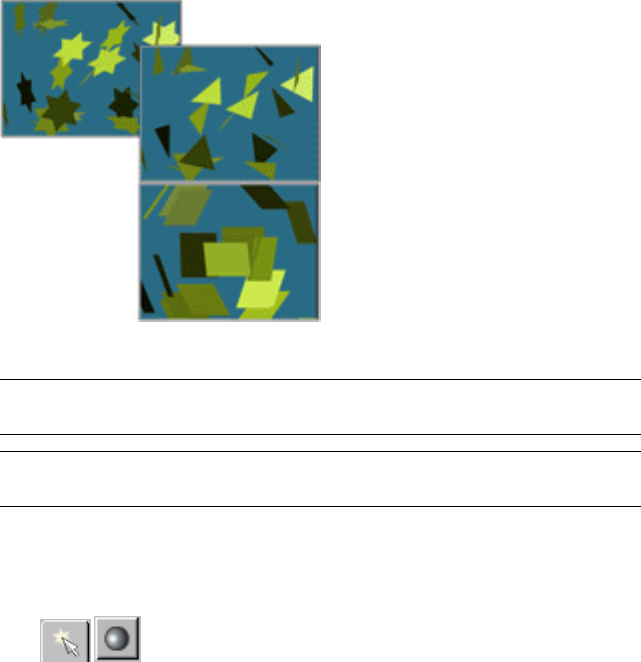
Snow simulates falling snow or confetti. The snow system is similar to Spray,
but it has additional parameters to generate tumbling snowflakes, and its
rendering options are different.
Kinds of Snow
NOTE Blizzard on page 2951 is a more powerful and advanced version of Snow.
It provides all the functionality of Snow, plus additional features.
TIP To animate particles following a path through space, use the Path Follow
space warp on page 2635 .
Procedures
To create snow:
1 In the Create panel, make sure the Geometry button is active
and Particle Systems is selected from the object category drop-down list,
then click Snow.
2Drag in a viewport to create the Snow emitter; see Creating a Particle
Emitter on page 2928 .
The emitter's direction vector points in the negative Z direction of the
active construction plane.
Non-Event-Driven Particle Systems | 2943
Interface
2944 | Chapter 12 Space Warps and Particle Systems

Particles group
Viewport Count Maximum number of particles displayed in viewports at
any given frame.
TIP Setting the viewport count less than the render count can improve viewport
performance.
Render Count Maximum number of particles that can appear in a single
frame when you render it. Works in combination with the particle system's
timing parameters.
■When the number of particles reaches the Render Count value, particle
creation is suspended until some particles die.
■When enough particles die, particle creation resumes until Render Count
is reached again.
Flake Size Size of a particle in the active units.
Speed Initial velocity of each particle as it leaves the emitter. Particles travel
at this speed unless they are affected by a particle system space warp.
Variation Varies the initial speed and direction of particles. The greater the
Variation, the broader the area of snowfall.
Tumble Amount of random rotation for snowflake particles. This parameter
can range from 0 to 1. At 0, flakes do not rotate; at 1, they rotate the most.
The axis of rotation is generated randomly for each particle.
Tumble Rate Speed at which snowflakes rotate. The greater the Tumble Rate,
the faster the rotation.
Flakes, Dots, or Ticks Select how particles are displayed in viewports. The
display setting does not affect how particles are rendered. Flakes are star-shaped
snowflakes, dots are points, ticks are small plus signs.
Render group
Six Point Each particle is rendered as a six-pointed star. Each side of the star
is a face to which you can assign a material. This is the default setting for
rendering.
Triangle Each particle is rendered as a triangle. Only one side of the triangle
is a face to which you can assign a material.
Non-Event-Driven Particle Systems | 2945

Facing Particles are rendered as square faces whose width and height equals
the Drop Size. Facing particles always face the camera (or the user's perspective).
They are provided especially for use with material maps. Use with an
appropriate opacity map for bubbles or snowflakes.
NOTE Facing works correctly only in a perspective or camera view.
Timing group
Timing parameters control the "birth and death" rates of emitted particles.
At the bottom of the Timing group is a line that displays the maximum
sustainable rate. This value is based on the Render Count and the lifetime of
each particle. To be precise:
maximum sustainable rate=Render Count/Life
Because the number of particles in a frame never exceeds Render Count, if
the Birth Rate exceeds the maximum rate, the system will run out of particles,
pause until some die off, and then start again, generating bursts or spurts of
particles.
Start Number of the first frame where particles appear.
Life The lifetime of a particle, in number of frames.
Birth Rate The number of new particles born per frame.
If this is less than or equal to the maximum sustainable rate, the particle
system generates an even flow of particles. If it is greater than the maximum
rate, the particle system generates particles in bursts.
You can animate the Birth Rate parameter.
Constant When on, Birth Rate is unavailable and the birth rate used equals
the maximum sustainable rate. When off, Birth Rate is available. Default=on.
Turning Constant off does not mean that the birth rate varies automatically;
the birth rate remains constant unless you animate the Birth Rate parameter.
Emitter Group
The emitter specifies the area where particles appear in the scene. It has a
geometry you can display in viewports, but it isn't renderable.
The emitter is displayed as a rectangle with a vector pointing out of one side.
The vector shows the direction in which the system emits particles.
2946 | Chapter 12 Space Warps and Particle Systems
You set emitter parameters in the Emitter group of the particle system's
Parameters rollout.
Width and Length You implicitly set the initial value of these parameters
when you drag in a viewport to create the emitter. You can adjust the values
in the rollout.
The space occupied by the particle system at any given time is the result of a
combination of its initial parameters (size of the emitter, and speed and
variation of emission) and any space warps that have been applied.
Hide Turn on to hide the emitter in viewports. When off, the emitter is
displayed in viewports. The emitter is never rendered. Default=off.
Super Spray Particle System
Create panel > Geometry button > Choose Particle Systems from the drop-down
list. > Object Type rollout > Super Spray
Create menu > Particles > Super Spray
Super Spray emits a controlled spray of particles. This particle system is like
the simple Spray particle system with the added power provided by all the
newer particle systems.
Non-Event-Driven Particle Systems | 2947
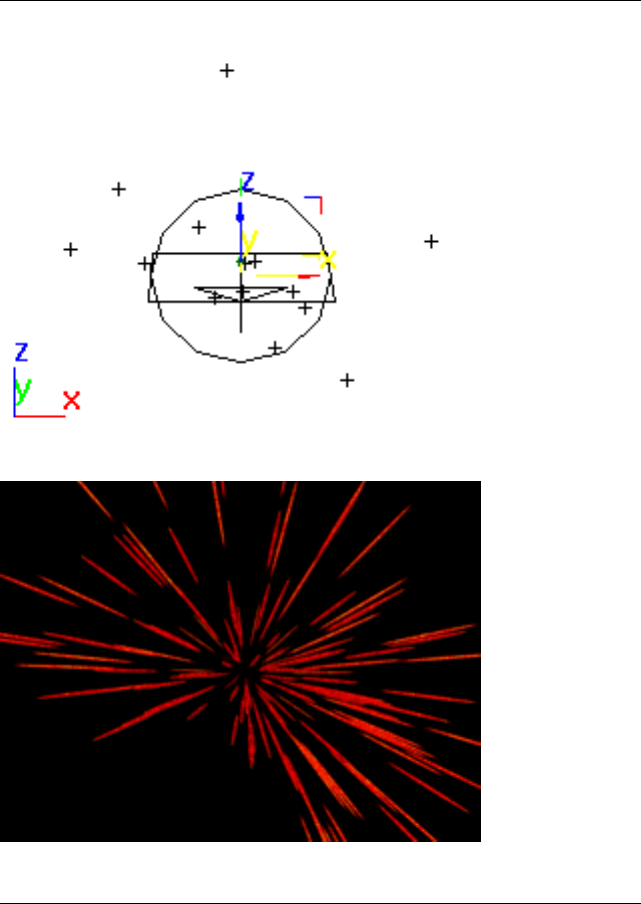
TIP To animate particles following a path through space, use the Path Follow
space warp on page 2635 .
Super Spray viewport icon (emitter)
Particles emerging from a super spray system
2948 | Chapter 12 Space Warps and Particle Systems
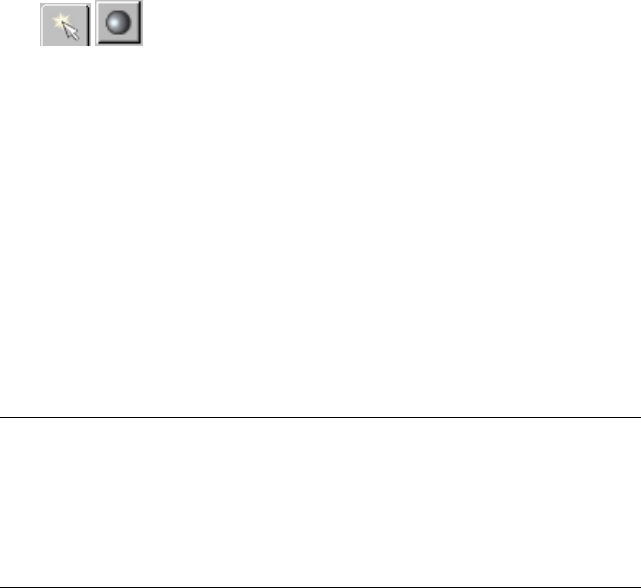
Procedures
To create a super spray particle system:
1 On the Create panel, make sure the Geometry button is
active and Particle Systems is chosen in the object category list, then click
Super Spray.
2Drag in any viewport to create the Super Spray emitter icon; see Creating
a Particle Emitter on page 2928 .
The icon appears as an intersecting plane and circle with an arrow. The
initial direction of the spray (based on the orientation of the emitter icon
and indicated by the icon arrow) depends on the viewport in which you
create the icon. Generally, the particles spray toward you when created
in an orthographic viewport, or spray upward when created in a
Perspective viewport.
3Adjust the various parameters to alter the spray effect.
Interface
NOTE This section describes the Particle Formation group in the Basic Parameters
rollout, and the Particle Motion group in the Particle Generation rollout. These
are the only controls unique to Super Spray. The other Super Spray rollouts and
their contents are identical with those in Particle Array, except that Object
Fragments and associated settings are not available on the Particle Type rollout.
See PArray Particle System on page 2964 for details or choose from the following
list for rollout information.
Particle Generation Rollout on page 2973
Particle Type Rollout on page 2977
Rotation and Collision Rollout on page 2987
Object Motion Inheritance Rollout on page 2990
Bubble Motion Rollout on page 2991
Particle Spawn Rollout on page 2992
Load/Save Presets Rollout on page 2999
Non-Event-Driven Particle Systems | 2949
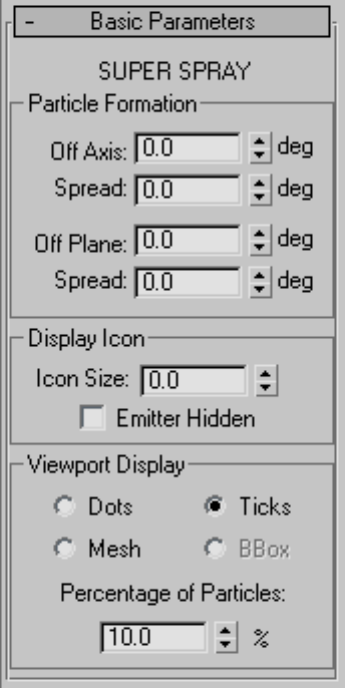
Basic Parameters rollout > Particle Formation group
These items control the direction and spread of particles.
Off Axis Affects the angle of the particle stream off the Z axis (along the
plane of the X axis).
Spread Affects the spread of the particles away from the emission vector
(along the plane of the X axis).
Off Plane Affects the angle of emission about the Z axis. This has no effect
if Off Axis is set to 0.
Spread Affects the spread of the particles about the Off Plane axis. This has
no effect if Off Axis is set to 0.
2950 | Chapter 12 Space Warps and Particle Systems
Particle Generation rollout > Particle Motion group
Speed The speed of the particle at birth, in units per frame.
Variation Applies a percentage of variation to the speed of emission for each
particle.
Blizzard Particle System
Create panel > Geometry button > Choose Particle Systems from the drop-down
list. > Object Type rollout > Blizzard
Create menu > Particles > Blizzard
This is an advanced version of the original Snow particle system.
Non-Event-Driven Particle Systems | 2951
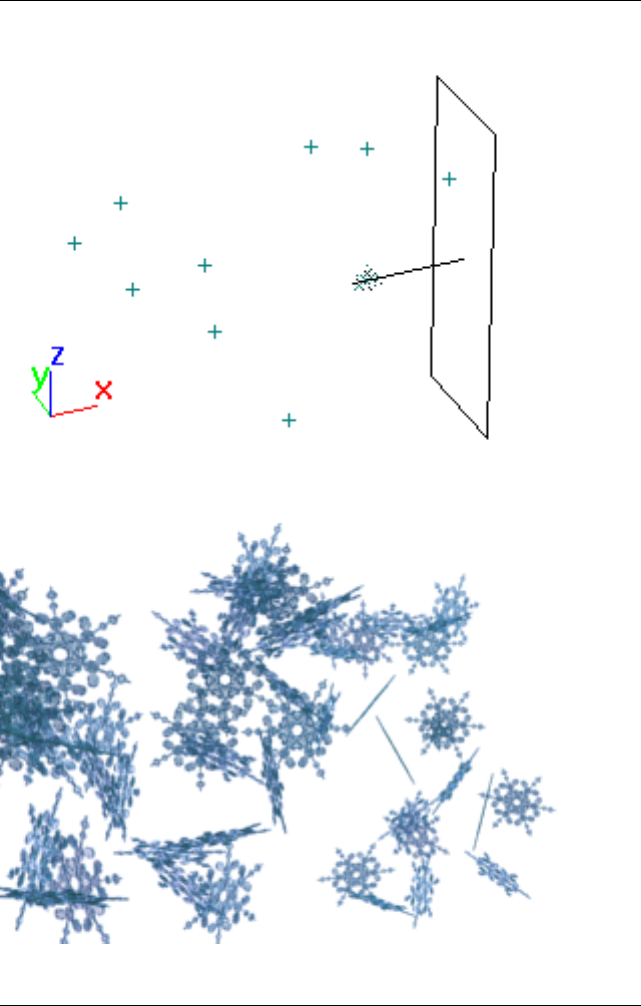
TIP To animate particles following a path through space, use the Path Follow
space warp on page 2635 .
Blizzard viewport icon (emitter)
Snowflake particles in a blizzard
2952 | Chapter 12 Space Warps and Particle Systems

Procedures
To create a blizzard particle system:
1 On the Create panel, make sure the Geometry button is
active and Particle Systems is chosen in the object category list, then click
Blizzard.
2Drag in a viewport to create the Blizzard emitter; see Creating a Particle
Emitter on page 2928 .
The icon appears as a plane with a perpendicular line pointing in the
direction of emission.
3Adjust the various parameters on the command panel.
Interface
This section describes the Display Icon group in the Basic Parameters rollout,
the Particle Motion group in the Particle Generation rollout, and the Material
Mapping and Source group in the Particle Type rollout. These are the only
controls unique to Blizzard. The other Blizzard rollouts and their contents are
identical with those in Particle Array, except that Object Fragments and
associated settings are not available on the Particle Type rollout. See PArray
on page 2964 for details or choose from the following list for rollout information.
Particle Generation Rollout on page 2973
Particle Type Rollout on page 2977
Rotation and Collision Rollout on page 2987
Object Motion Inheritance Rollout on page 2990
Particle Spawn Rollout on page 2992
Load/Save Presets Rollout on page 2999
Non-Event-Driven Particle Systems | 2953
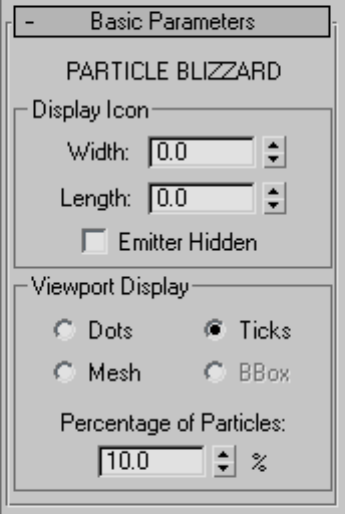
Basic Parameters rollout > Display Icon group
The emitter specifies the location where particles are generated in the scene.
It has a geometry you can display in viewports, but it isn't renderable.
The emitter is displayed as a rectangle with a vector pointing out of one side.
The vector shows the direction in which the system emits particles.
You set emitter parameters on the particle system's Basic Parameters rollout,
in the Display Icon group.
Width and Length You implicitly set the initial value of these parameters
when you drag in a viewport to create the emitter. You can adjust the values
on the rollout.
The space occupied by the particle system at any given time is the result of a
combination of its initial parameters (such as size of the emitter, and speed
and variation of emission) and any space warps that have been applied.
Emitter Hidden Hides the emitter in viewports. When off, the emitter is
displayed in viewports. The emitter is never rendered. Default=off.
2954 | Chapter 12 Space Warps and Particle Systems

Particle Generation rollout > Particle Motion group
Specifies the number, size, and motion of particles.
Speed The speed of the particle at birth, in units per frame.
Non-Event-Driven Particle Systems | 2955
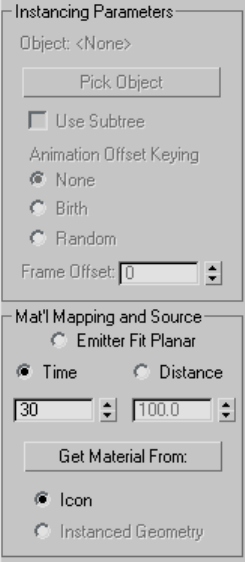
Variation Applies a percentage of variation to the speed of emission for each
particle.
Tumble Amount of random rotation of the particles.
Tumble Rate Speed at which the particles rotate.
Particle Type rollout > Mat'l Mapping and Source group
Emitter Fit Planar Maps particles at birth, based on their point of emission
from the rectangular Blizzard emitter icon. The UV range of the mapped
material runs from 0 to 1 over the width and length of the emitter.
PCloud Particle System
Create panel > Geometry button > Choose Particle Systems from the drop-down
list. > Object Type rollout > PCloud
2956 | Chapter 12 Space Warps and Particle Systems
Create menu > Particles > PCloud
Use the PCloud (or Particle Cloud) particle system when you want a "cloud"
of particles that fill a specific volume. PCloud can provide a flock of birds, a
starfield, or a troupe of soldiers marching over terrain. You can confine the
particles using basic supplied volumes of a box, sphere, or cylinder, or you
can use any renderable object in the scene as a volume as long as that object
has depth. Two-dimensional objects do not work with PCloud.
Non-Event-Driven Particle Systems | 2957
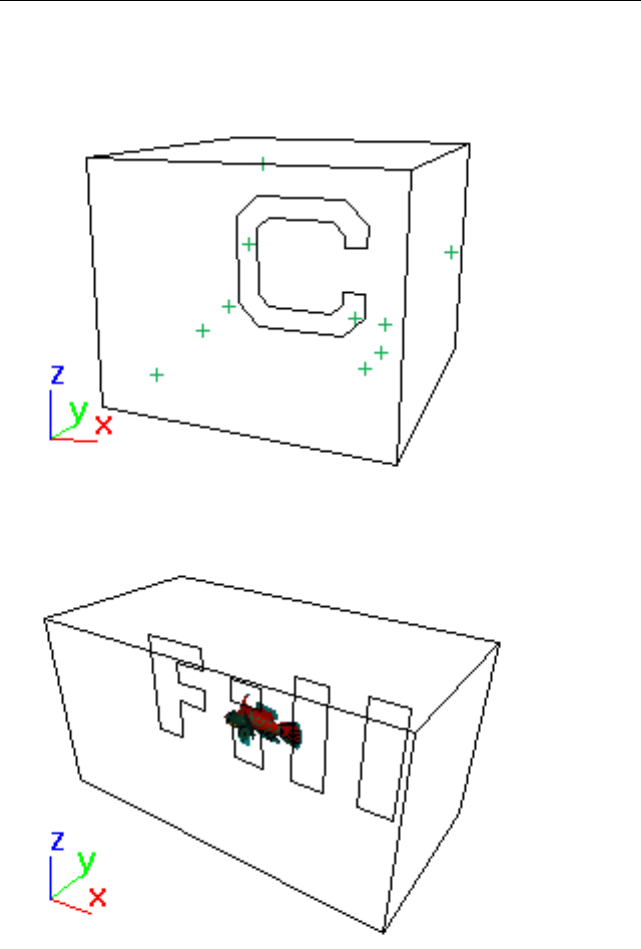
TIP There is no automatic way to hide the object chosen as the object-based
emitter. Hide it by using Hide Selected on the Display panel, or by applying a Hide
key in Track View.
PCloud viewport icon (default emitter)
PCloud viewport icon (object-based emitter)
2958 | Chapter 12 Space Warps and Particle Systems
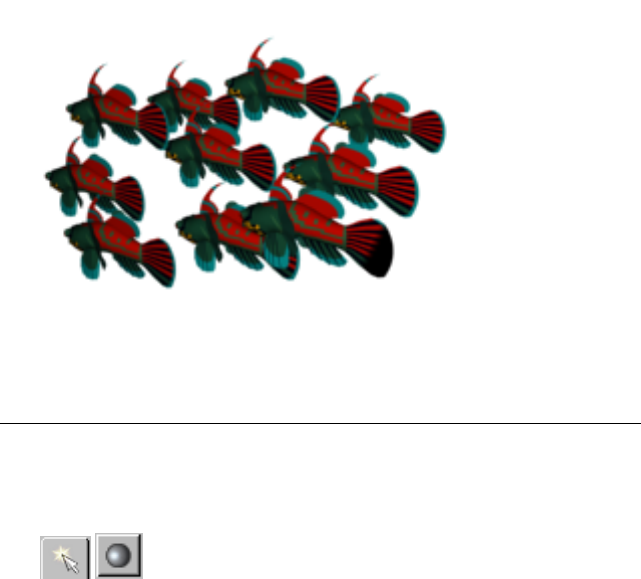
PCloud used to form a school of fish (each fish is a particle)
Procedures
To create a particle cloud:
1 On the Create panel, make sure the Geometry button is
active and Particle Systems is chosen in the object category list, then click
PCloud.
2Drag in a viewport to create the PCloud emitter; see Creating a Particle
Emitter on page 2928 .
Adding a PCloud emitter works the same way as creating a box primitive:
First drag out the length and width, then release the mouse button and
move the mouse vertically to set the height, and then click to finish.
The emitter appears with a letter "C" representing the particle cloud.
3Adjust the various parameters on the command panel.
Interface
This section describes the Object-Based Emitter, Particle Formation, and Display
Icon groups in the Basic Parameters rollout, and the Particle Motion group in
the Particle Generation rollout. These are the only controls unique to PCloud.
Non-Event-Driven Particle Systems | 2959
The other PCloud rollouts and their contents are identical with those in Particle
Array, except that Object Fragments and associated settings are not available
on the Particle Type rollout. See PArray on page 2964 for details or choose from
the following list for rollout information.
Particle Generation Rollout on page 2973
Particle Type Rollout on page 2977
Rotation and Collision Rollout on page 2987
Object Motion Inheritance Rollout on page 2990
Bubble Motion Rollout on page 2991
Particle Spawn Rollout on page 2992
Load/Save Presets Rollout on page 2999
2960 | Chapter 12 Space Warps and Particle Systems
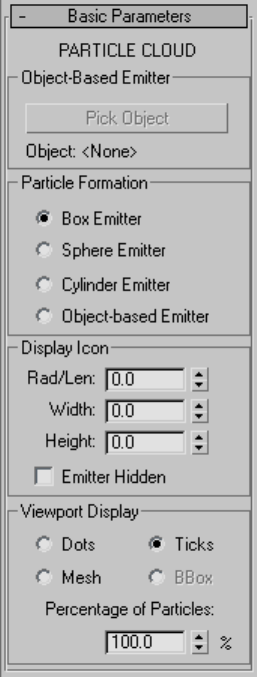
Basic Parameters rollout
Object-Based Emitter group
This button lets you select a renderable mesh object to use as a particle emitter.
This object is used only when the Object-Based Emitter option is chosen in
the Particle Formation group.
Pick Object Click this, and then select a renderable mesh object to be used
as a custom emitter.
Object Displays the name of the picked object.
Non-Event-Driven Particle Systems | 2961

Particle Formation group
These options let you specify the shape of the emitter.
Box Emitter Chooses a box-shaped emitter.
Sphere Emitter Chooses a sphere-shaped emitter.
Cylinder Emitter Chooses a cylindrical emitter.
Object-Based Emitter Chooses the object selected in the Object-Based Emitter
group.
NOTE With regard to animation of the object-based emitter, the particles will
properly fill a deformed object at frame 0, but they can't stay with the emitter
while it's moving. If the emitter moves in a straight line, this can give the
appearance of the cloud moving with the emitter.
Display Icon group
These options let you adjust the dimensions of the emitter icon when a custom
object is not used as an emitter. When a custom object is used you can still
resize the "Fill" icon using these options.
Rad/Len Adjusts the radius of a spherical or cylindrical icon, and the length
of a box icon.
Width Sets the width of a box emitter.
Height Sets the height of a box or cylindrical emitter.
Emitter Hidden Hides the emitter.
2962 | Chapter 12 Space Warps and Particle Systems
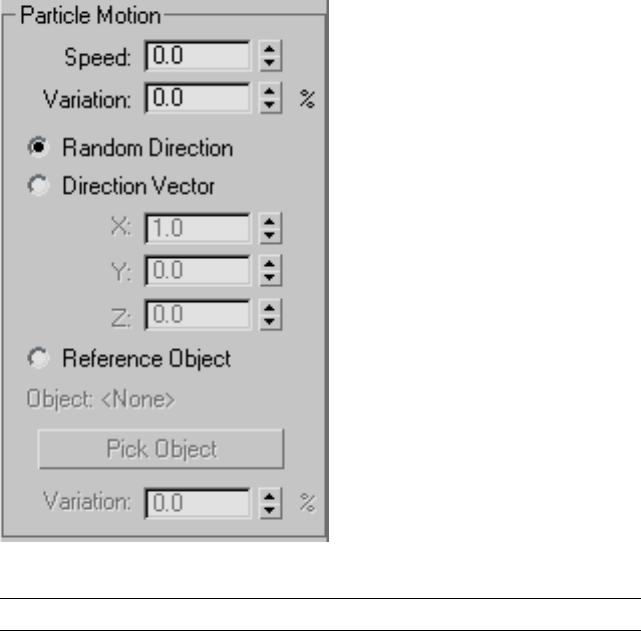
Particle Generation rollout > Particle Motion group
Speed The speed of the particle at birth along the normal, in units per frame.
NOTE For the correct volume effect, Speed should be set to 0.
Variation Applies a percentage of variation to the speed of emission for each
particle.
Random Direction One of three options that affect the direction of the
particles. This option emits particles in random directions.
Direction Vector Specifies the direction of the particles by a vector defined
by the three X, Y, and Z spinners.
X/Y/Z Displays the particle direction vectors.
Reference Object Emits particles in the direction of the local Z axis of a
specified object.
Object Displays the name of the picked object.
Non-Event-Driven Particle Systems | 2963
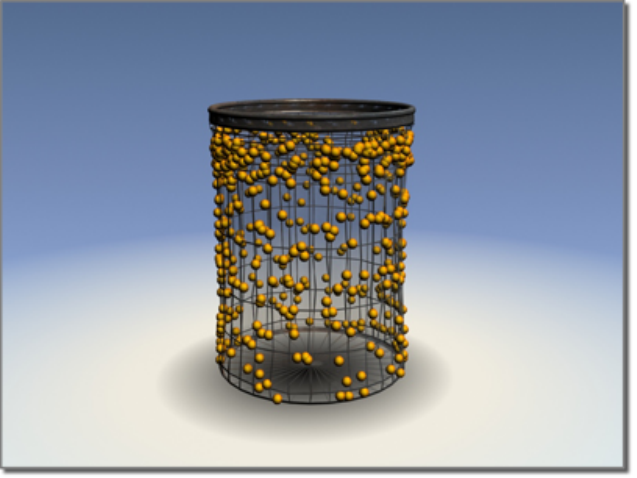
Pick Object Click this, and then select an object in the scene to use as a
reference object. This button is available only when you choose Reference
Object.
Variation Applies a percentage of variation to the direction when you choose
either the Direction Vector or Reference Object option. This spinner is
unavailable and has no effect when you choose Random Direction.
PArray Particle System
Create panel > Geometry button > Choose Particle Systems from the drop-down
list. > Object Type rollout > PArray
Create menu > Particles > PArray
Basket used as a distribution object for random particles over its surface
The PArray (Particle Array) particle system provides two types of particle effects:
■You can use it to emit particles using a selected geometric object as the
emitter template (or pattern) for the emission. This object is referred to
here as the distribution object.
2964 | Chapter 12 Space Warps and Particle Systems
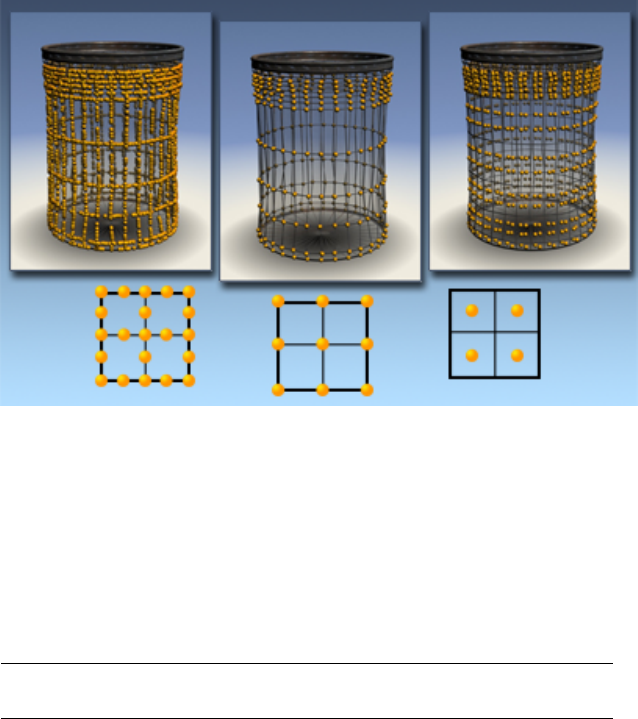
How particles can be distributed on an object:
Left: Edges
Center: Vertices
Right: Faces
■You can use it to create sophisticated object explosions.
TIP A good way to create explosions is to set the particle type to Object
Fragments and then apply a PBomb space warp on page 2629 .
See also:
■Particle System Usage on page 2926
■Using Materials with Particle Array on page 2929
■Achieving Particle Motion Blur on page 2932
■Using Mapped Materials with Particle Systems on page 2932
■Using Multi/Sub-Object Materials with Particle Systems on page 2934
Non-Event-Driven Particle Systems | 2965

■Using Spawned Particles on page 2935
■Using Interparticle Collision on page 2937
Procedures
To set up a particle array:
1Create an object that will become the distribution object, providing the
emitter pattern (or exploded object) for the particle array.
2 On the Create panel, make sure the Geometry button is
active and Particle Systems is chosen in the object category list, then click
PArray.
3Drag anywhere in a viewport to create the particle-system object; see
Creating a Particle Emitter on page 2928 .
4On the Basic Parameters rollout, click Pick Object, and then click the
object to use as the distribution object.
5Adjust the various options in the Particle Array rollouts to achieve the
effect you want.
The distribution object can be any object containing renderable faces.
The particle-system object does not appear in the rendered scene. Its
placement, orientation or size in the scene has no influence on the particle
effect. To access the Particle Array parameters after creation, open the
Modify panel and select the particle-system object (or click any visible
particles in the viewport). To transform or otherwise modify the
distribution object, select the distribution object itself.
Also, you can share a single distribution object among more than one
particle-system object. The distribution object merely provides the
template for the particles, which are actually generated by the particle
system.
Example: To assign three different mapped materials to fragments:
1Apply mapping coordinates to the distribution object, either by turning
on Generate Mapping Coords, if necessary, or by applying a UVW Map
modifier on page 1849 .
2Assign a Multi/Sub-Object material on page 5558 to the distribution object.
2966 | Chapter 12 Space Warps and Particle Systems

3Set up the first three sub-materials to be mapped materials.
4Select the PArray icon.
5On the Particle Type rollout in the Mat'l Mapping And Source group,
choose Picked Emitter.
6In the Particle Type rollout > Particle Types group, turn on Object
Fragments.
7Make sure the three spinners in the Fragment Materials group are set to
1, 2, and 3, respectively (or match the numbers with the sub-materials
you've assigned in your multi/sub-object material).
TIP Using a complex distribution object for object-fragment particles can
really slow down viewport interaction. You can use a simple stand-in object
as the distribution object, and then later use the File/Replace command to
replace the distribution object with a more complex object of the same name.
Interface
Basic Parameters Rollout (PArray) on page 2967
Particle Generation Rollout on page 2973
Particle Type Rollout on page 2977
Rotation and Collision Rollout on page 2987
Object Motion Inheritance Rollout on page 2990
Bubble Motion Rollout on page 2991
Particle Spawn Rollout on page 2992
Load/Save Presets Rollout on page 2999
Basic Parameters Rollout (PArray)
Create panel > Geometry button > Choose Particle Systems from the drop-down
list. > Object Type rollout > Parray > Basic Parameters rollout
The items on the Basic Parameters rollout let you create and adjust the size of
the particle system, and pick the distribution object. In addition, they let you
specify the initial distribution of the particles in relation to the geometry of
the distribution object, and the initial velocity of the particles from the
Non-Event-Driven Particle Systems | 2967
distribution object. From here, you can also specify how the particles appear
in the viewport.
2968 | Chapter 12 Space Warps and Particle Systems
Interface
Non-Event-Driven Particle Systems | 2969
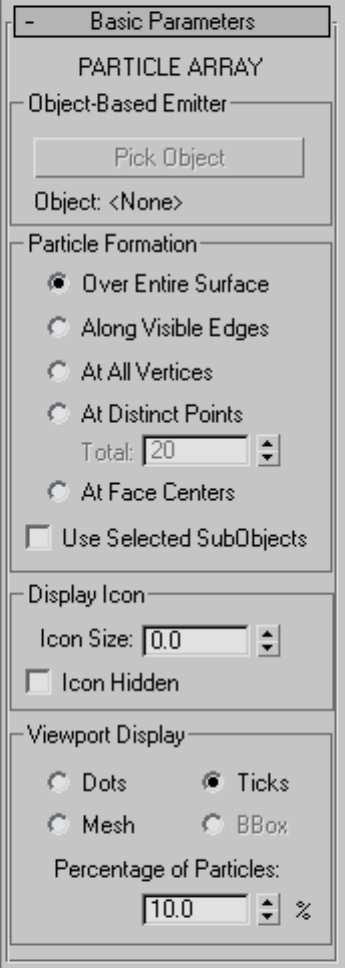
2970 | Chapter 12 Space Warps and Particle Systems
Object-Based Emitter group
Pick Object After you create the particle-system object, the Pick Object button
becomes available. Click this button, and then click to select an object in your
scene. The selected object becomes the object-based emitter, and is used either
as the source geometry over which particles form, or the source geometry used
to create particles that appear to be fragments of the object.
Object text field Displays the name of the picked object.
Particle Formation group
These options determine how standard particles are initially distributed over
the surface of the object-based emitter. These controls are available only when
the picked object is used as a distribution grid for standard particles,
MetaParticles, or instanced geometry; see Particle Type rollout on page 2977 .
When Object Fragments is chosen in the Particle Type rollout, these controls
are unavailable.
Over Entire Surface Emits particles randomly over the entire surface of the
object-based emitter. This is the default choice.
Along Visible Edges Emits particles randomly from the visible edges of the
object.
At All Vertices Emits particles from the vertices of the object.
At Distinct Points Places a specified number of emitter points randomly over
the surface of the object.
Total Specifies the number of emitter points used when At Distinct Points
is chosen.
At Face Centers Emits particles from the center of each triangular face.
Use Selected SubObjects With mesh-based emitters, and to a limited extent
with patch-based emitters, limits the source of the particle stream to the
sub-object selection passed up the modifier stack in the object-based emitter.
For example, if your emitter object is a cylinder converted to an editable mesh,
and the top cap of that cylinder is selected at the Face or Polygon sub-object
level, if Use Selected SubObjects is on and Particle Formation group > At Face
Centers is on, the particles will stream only from the top cap of the cylinder.
Default=off.
The type of particle formation you specify determines the type of sub-object
geometry used, as follows:
■Over Entire Surface Faces
Non-Event-Driven Particle Systems | 2971

■Along Visible Edges Edges
■At All Vertices Vertices
■At Distinct Points Faces
■At Face Centers Faces
If you’ve converted your object to an editable mesh, and selected different
sub-object sections of it with vertex, edge, and face selection, as you switch
particle formation options, you’ll see the particles emit from different areas
of the object.
NOTE Use Selected SubObjects is applicable to patch object emitters only at
the patch and element sub-object levels, and is not applicable NURBS objects
used as emitters.
TIP You can best see the emission patterns by first setting Speed on the Particle
Generation rollout > Particle Motion group to 0. Move to a frame in which the
particles appear, and then choose the various particle formation options.
Display Icon group
Adjusts the display of the particle-system icon in the viewports. (The
particle-system icon is usually called the "emitter." In this case, however, it
doesn't actually emit particles, so we're avoiding the term.)
Icon Size Sets the overall size of the icon, in units.
Icon Hidden When on, the PArray icon is hidden in the viewports. Note
that the icon does not render, in any case. Default=off.
Viewport Display group
Specifies how the particles are displayed in the viewports.
Dots Displays the particles as dots.
Ticks Displays the particles as crosses.
Mesh Displays the particles as mesh objects. This results in slower viewport
redraws.
BBox For instanced geometry only, this displays each instanced particle,
whether a single object, a hierarchy, or a group, as a bounding box.
2972 | Chapter 12 Space Warps and Particle Systems
Percentage of Particles This spinner specifies the number particles displayed
in the viewports as a percentage of the number of rendered particles.
Default=10 percent.
Set the display percentage to 100 percent if you want to see the same number
of particles as will be rendered in your scene. However, this can considerably
slow viewport display.
Particle Generation Rollout
Create panel > Geometry button > Choose Particle Systems from the drop-down
list. > Object Type rollout > SuperSpray/Blizzard/Parray/PCloud > Particle
Generation rollout
Select a SuperSpray/Blizzard/Parray/PCloud emitter. > Modify panel > Particle
Generation rollout
Items on this rollout control when and how quickly particles form, how
particles move, and the size of the particles over time.
Non-Event-Driven Particle Systems | 2973
Interface
2974 | Chapter 12 Space Warps and Particle Systems
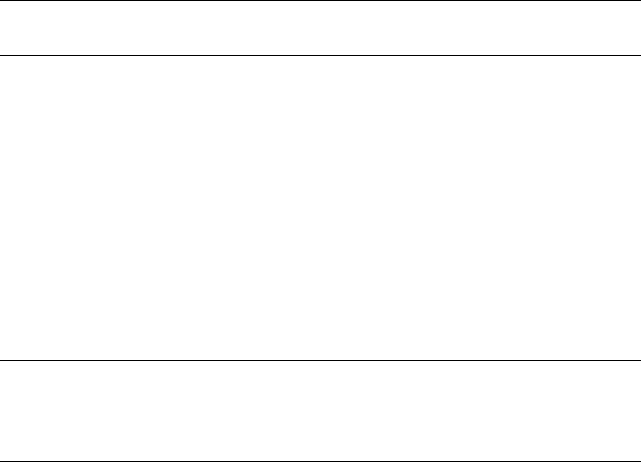
Particle Quantity group
In this group, you can choose one of two methods by which the number of
particles is determined over time. These settings are unavailable if you set
Particle Type (in the Particle Type rollout on page 2977 ) to Object Fragments.
Use Rate Specifies a fixed number of particles emitted per frame. Use the
spinner to set the number of particles formed per frame.
Use Total Specifies a total number of particles formed over the life of the
system. Use the spinner to set the number of particles formed per frame.
The life of the system, in frames, is specified by the Life spinner in the Particle
Timing group, described later in this topic.
TIP Generally, Use Rate is best for a continuous flow of particles, like a trail of pixie
dust, while Use Total is better for bursts of particles over a short period of time.
Particle Motion group
These spinners control the initial particle velocity, which is directed along
the surface, edge, or vertex normals (interpolated for each emitter point).
Speed The velocity of the particle at birth, along the normal, in units traveled
per frame.
Variation Applies a percentage of variation to the speed of emission for each
particle.
Divergence Applies an angular degree of variation by which each particle's
velocity can vary from the emitter normal.
NOTE The initial direction for a fragment cluster is the normal of the cluster's seed
face. Clusters are created by choosing a single face (the seed face), and then
creating a cluster outward from that face, depending on the method chosen in
the Object Fragment Controls group on the Particle Type rollout.
Particle Timing group
These options specify when particle emission starts and stops, and the lifespan
of the individual particles.
Emit Start Sets the frame at which particles begin to exist in the scene.
Emit Stop Sets the last frame at which particles are emitted. This setting has
no effect if you choose the Object Fragments particle type.
Non-Event-Driven Particle Systems | 2975

Display Until Specifies the frame at which all particles will disappear,
regardless of other settings.
Life Sets the lifespan in number of frames of each particle from the frame
of creation.
Variation Specifies the number of frames by which the life of each particle
can vary from the norm.
Subframe Sampling Turning on any of the three check boxes below helps
avoid particle "puffing" by sampling particles at a much higher subframe
resolution, instead of the relatively coarse frame resolution. Depending on
your needs, you can do this over time, over motion, or over rotation. "Puffing"
is the effect of emitting separate "puffs" or clusters of particles, rather than a
continuous stream. This effect is especially noticeable when the emitter is
animated.
■Creation Time Enables the addition of a time offset to the equations of
motion that prevents puffing in time. This setting has no effect with the
Object Fragments particle type. Default=on.
■Emitter Translation If the object-based emitter is moving in space,
particles are created at integral times at positions along the geometry's
path between renderable positions. This prevents puffing in space. This
setting has no effect if Object Fragment particle type is on. Default=on.
■Emitter Rotation If the emitter is rotating, turn this on to avoid puffing
and produce smooth spiral effects. Default=off.
IMPORTANT Each additional subframe sampling check box that you turn on
progressively increases the necessary computation. In addition, the methods
are listed in order of least amount of computation to most. Thus, Emitter
Rotation is more costly than Emitter Translation, which is more costly than
Creation Time.
Particle Size group
These spinners specify the size of the particles.
Size This animatable parameter specifies the target size for all particles in
the system, depending on the type of particle:
■Standard Particles The major dimension of the particle.
■Constant The dimension, in rendered pixels, of a Constant type of
particle.
2976 | Chapter 12 Space Warps and Particle Systems
■Object Fragments No effect.
Variation The percentage by which the size of each particle may vary from
the norm. This is applied to the Size value. Use this parameter to get a realistic
mix of large and small particles.
Grow For The number of frames over which the particle grows from being
very small to the Size value. The result is subject to the Size/Variation value,
since Grow For is applied after Variation. Use this parameter to simulate natural
effects such as bubbles growing as they reach the surface.
Fade For The number of frames over which the particle will shrink to 1/10th
its Size setting prior to its death. This is also applied after Variation. Use this
parameter to simulate natural effects such as sparks fading to ash.
Uniqueness group
By changing the Seed value in this spinner, you achieve different results using
otherwise identical particle settings.
New Randomly generates a new seed value.
Seed Sets a specific seed value.
Particle Type Rollout
Create panel > Geometry button > Choose Particle Systems from the drop-down
list. > Object Type rollout > SuperSpray/Blizzard/Parray/PCloud > Particle Type
rollout
Select a SuperSpray/Blizzard/Parray/PCloud emitter. > Modify panel > Particle
Type rollout
Non-Event-Driven Particle Systems | 2977
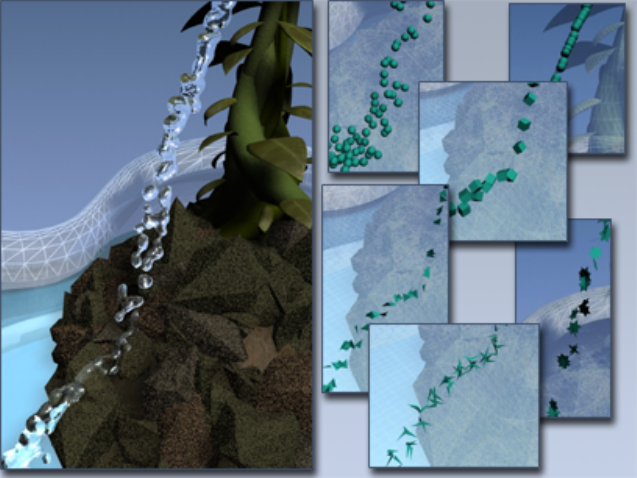
Left: A stream from a fountain
Right: The same stream with various types of particles
The controls on this rollout let you specify the type of particle used and the
type of mapping performed on the particles.
2978 | Chapter 12 Space Warps and Particle Systems

Interface
Non-Event-Driven Particle Systems | 2979

Particle Types group
These options specify one of four categories of particle type. Depending on
which option you choose, different controls become available in the lower
portion of the Particle Type rollout.
Standard Particles Uses one of several standard particle types, such as triangle,
cube, tetra, and so on.
MetaParticles Uses Metaball particles. These are particle systems in which
the individual particles blend together in blobs or streams.
Object Fragments Creates particles out of fragments of an object.
Object Fragments is available only with Particle Array. Choose it when you
want to fracture the particle emitter object and use the pieces as particles. This
option is useful for animating explosions and shattering collisions.
The fragments are created at the Emit Start frame. The Use Rate, Use Total,
Emit Stop, and Particle Size parameters are unavailable.
Instanced Geometry Generates particles that are instances of either an object,
a linked hierarchy of objects, or a group. The object is selected in the Instancing
Parameters group on the Particle Type rollout.
Choose Instanced Geometry when you want particles to be identical instances
of another object in your scene. Instanced geometry particles are extremely
effective for creating crowds, flocks, or flows of very detailed objects. Here are
a few examples:
■Instance a red blood cell and use Super Spray to animate blood flowing in
an artery.
■Instance a bird and use Particle Cloud to animate a flock of birds flying.
■Instance a rock and use Particle Cloud to animate an asteroid field.
NOTE Only one type of particle can be used for the particle system. However,
you can have more than one particle array bound to a single object, and each
particle array can emit a different type of particle.
TIP Image motion blur, described in Object Properties on page 245 > Motion
Blur group, is known not to work properly with instanced particles. Use object
motion blur with instanced particles, or use image motion blur with standard
particles.
2980 | Chapter 12 Space Warps and Particle Systems

Standard Particles group
When you choose Standard Particles in the Particle Types group, the options
in this group become available. Choose one of the following options to specify
the particle type:
Triangle Renders each particle as a triangle. Use Triangle particles with noise
opacity for steam or smoke.
Cube Renders each particle as a cube.
Special Each particle consists of three intersecting 2D squares. These are
effective when you use a face-map material, described in Shader Basic
Parameters Rollout on page 5301 , optionally along with an opacity map, to
create the effect of a three-dimensional particle.
Facing Renders each particle as a square that always faces the view. Use with
an appropriate opacity map for bubbles or snowflakes.
Constant Provides a particle that remains the same size, in pixels, specified
in the Size spinner. This size never changes, regardless of its distance from the
camera.
IMPORTANT You must render either a camera or a perspective view for Constant
particles to render correctly.
Tetra Renders each particle as a mapped tetrahedron. Use Tetra particles for
raindrops or sparks.
The default alignment of the tetra particles depends on the particle system
type and emitter setup. To specify an alignment, use controls in the Rotation
and Collision rollout on page 2987 .
SixPoint Renders each particle as a six-pointed, two-dimensional star.
Sphere Renders each particle as a sphere.
MetaParticle Parameters group
When you choose the MetaParticles option in the Particle Types group, the
options in this group become available, and metaballs are used as particles.
Metaparticles take extra time to render but are very effective for spraying and
flowing liquid effects.
Tension Determines the tightness of the particles, with regard to their
tendency to blend with other particles. The higher the Tension, the harder
the blobs, and the harder it is for them to merge.
Non-Event-Driven Particle Systems | 2981
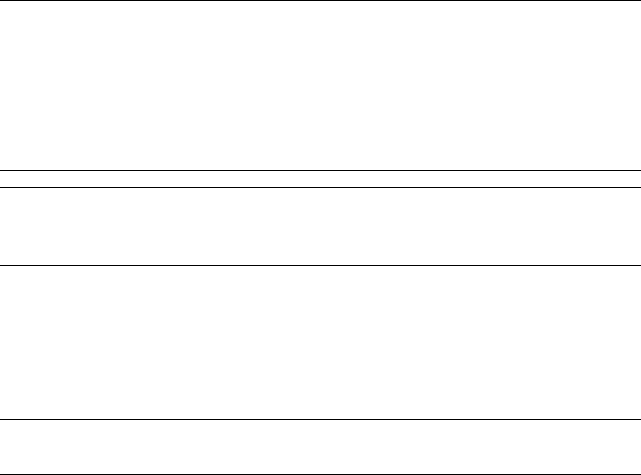
Variation Specifies the percent of variation of the Tension effect.
Evaluation Coarseness Specifies how accurately the metaparticle solution is
calculated. The higher the coarseness values, the less calculation. However, if
the coarseness is too high, there may be little or no metaparticle effect at all.
Conversely, if the coarseness is set too low, the time for calculation can become
extremely long.
Render Sets the coarseness for metaparticles in the rendered scene. This
option is unavailable when Automatic Coarseness is on.
Viewport Sets the coarseness for the viewport display. This option is
unavailable when Automatic Coarseness is on.
Automatic Coarseness A general rule is to set the Coarseness value between
1/4 and 1/2 the size of the particles. When this item is on, the rendering
coarseness is automatically set, based on the size of the particles, and the
viewport coarseness is set to about twice that of the rendering coarseness.
One Connected Blob When off (the default), all particles are calculated;
when on, a shortcut algorithm is used that calculates and displays only those
particles that are adjoining or contiguous to each other.
NOTE One Connected Blob mode speeds particle calculations, but you should
use it only when your metaparticles form one connected blob, as the label indicates.
That is, all particles' blobs must be touching. For example, if you were to use One
Connected Blob on a stream of particles containing a mass of 10 contiguous
particles followed by a space, then 12 contiguous particles followed by another
space, and finally 20 contiguous particles, one of the particles will be chosen, and
only the mass connected to that particle will be displayed and rendered.
TIP When in doubt, leave this option off. If you think all your particles are
contiguous and want to save time, turn on One Connected Blob, and then display
various frames to see if everything appears.
Object Fragment Controls group
With a particle array, when you choose the Object Fragments particle type,
the items in this group become available, and the object-based emitter is
exploded into fragments, rather than being used to distribute particles.
NOTE To see the fragments in the viewports, choose Mesh in the Viewport Display
group near the bottom of the Basic Parameters rollout on page 2967 .
The items in this group include a Thickness spinner, along with three option
buttons that determine how the fragments are formed.
2982 | Chapter 12 Space Warps and Particle Systems

TIP There is no automatic way to hide the distribution object that explodes into
fragments. To create the illusion that an object is exploding, you must either set
the original object to be invisible at the start of the explosion, as described in Add
Visibility Track on page 3533 , or move or scale the original object so it doesn't
remain in view.
Thickness Sets the thickness of the fragments. At 0, the fragments are
single-sided with no thickness. When greater than 0, the fragments are
extruded, at fragmentation time, by the amount specified. The outer and inner
surfaces of the fragment use identical smoothing, which is picked up from
the object-based emitter. The edges of the fragments are not smoothed.
The three options that follow specify how the object fragments.
All Faces Each face of the object becomes a particle. This results in triangular
particles.
Number of Chunks The object breaks into irregular fragments. The Minimum
spinner, below, specifies the minimum number of fragments that will appear.
The method of calculating the chunks may result in more fragments than
specified.
Minimum Determines a number of "seed" faces in the geometry. Each seed
face collects connecting faces surrounding it until all available faces are
exhausted. Any leftover faces become unique particles, thus increasing the
minimum number of fragments.
Smoothing Angle The fragments are broken based on the angles between
face normals, as specified in the Angle spinner. Generally, the higher the Angle
value, the fewer the number of fragments.
Angle Sets the amount of smoothing angle.
Non-Event-Driven Particle Systems | 2983
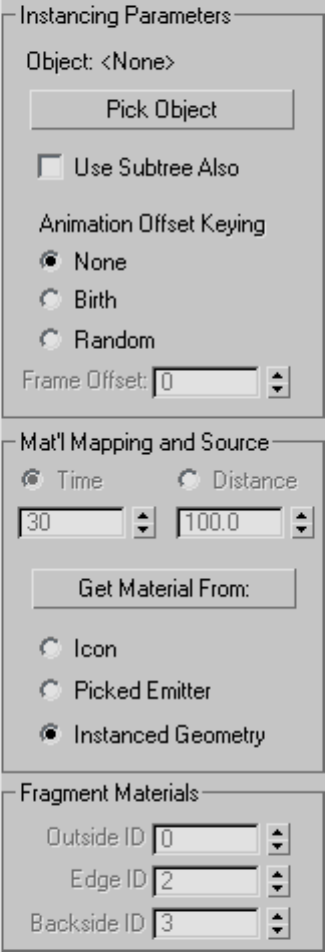
Instancing Parameters group
2984 | Chapter 12 Space Warps and Particle Systems
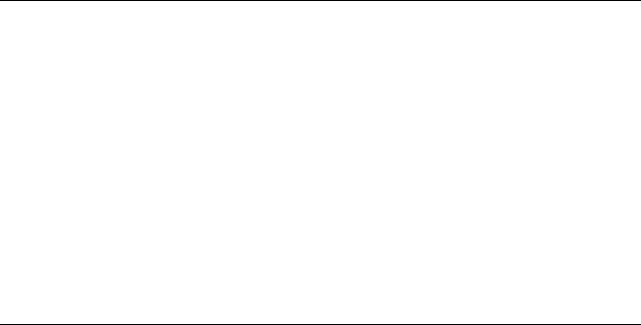
These options are used when you specify Instanced Geometry in the Particle
Types group. They let you generate each particle as an instance of either an
object, a linked hierarchy of objects, or a group.
NOTE Instanced objects can be animated, providing the animation incorporates
one or more of the following types:
■Animation of object geometry parameters, such as a sphere's Radius setting.
■Animation of object-space modifiers, such as the Angle setting of a Bend
modifier on page 1139 .
■Transform animation of a hierarchical object's children. Transform
animation of the top-level parent and non-hierarchical objects is not
supported. For example, if you use the toolbar Select and Rotate function
on page 889 to animate a box rotating, and then use the box as instanced
geometry with a particle system, the system will not use instanced box's
keyframed animation.
Object Displays the name of the picked object.
Pick Object Click this, and then select an object in the viewport to be used
as a particle. If you select an object that's part of a hierarchy and Use Subtree
Also is on, then the picked object and its children become a particle.
If you pick a group, all objects in the group are used as a particle.
Use Subtree Also Turn this on when you want to include the linked children
of the picked object in the particle. If the picked object is a group, all children
of the group are included. Note that you can turn this on or off at any time
to alter the particles.
Animation Offset Keying Because the instanced objects can be animated,
the options here let you specify the timing of the animations for the particles.
None Each particle duplicates the timing of the original object. As a result,
the animation of all particles will be identically timed.
Birth The firstborn particle is an instance of the current animation of the
source object at the moment of that particle's birth. Each subsequent particle
then uses the same start time for the animation. For example, if the animation
of the source object is a bend from 0 to 180 degrees, and the first particle is
born at frame 30, when the object is at 45 degrees, then that particle, and all
subsequent particles will be born starting at a bend of 45 degrees.
Random This option is the same as None when Frame Offset is set to 0.
Otherwise, each particle is born using the same animation as the source object
Non-Event-Driven Particle Systems | 2985
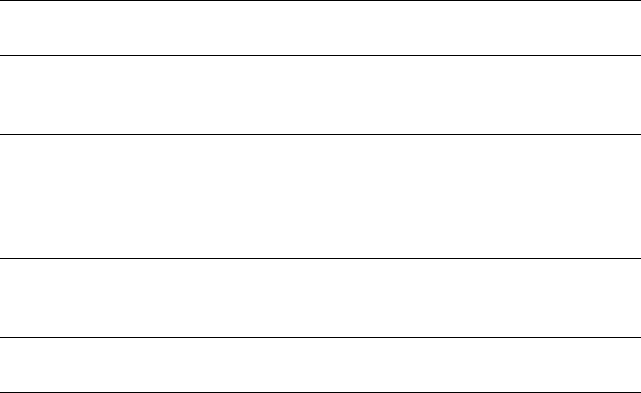
at the time of birth, but with a random offset of frames, based on the value
in the Frame Offset spinner.
Frame Offset Specifies an offset value from the current timing of the source
object.
Mat'l Mapping and Source group
Specifies how a mapped material affects the particles, and lets you specify the
source of the material assigned to the particles. A detailed description of how
materials affect particles is in the topic Using Mapped Materials with Particle
Systems on page 2932 .
Time Specifies the number of frames from the birth of the particle that it
takes to complete one mapping of the particle.
Distance Specifies the distance, in units, from the birth of the particle that
it takes to complete one mapping of the particle.
NOTE Tetra particles are an exception. They always have their own local mapping
from head to tail, as described in the following section.
Get Material From Updates the material carried by the particle system, using
the source specified by the option buttons below this button.
IMPORTANT Remember to click Get Material From whenever you choose a
different source option button, or whenever you assign a new material to the
specified source. Only a single material (or multi/sub-object material) is carried by
the particle-system object at any time. Thus, when you change sources, you actually
overwrite the currently assigned material with an instance of the source material.
Icon The particles use the material currently assigned to the particle system
icon.
NOTE The Time and Distance options are available only when you choose this
option.
Picked Emitter The particles use the material assigned to the distribution
object.
Instanced Geometry The particles use the material assigned to the instanced
geometry. This option is available only when you choose Instanced Geometry
in the Particle Types group.
2986 | Chapter 12 Space Warps and Particle Systems

IMPORTANT When you turn on either Picked Emitter or Instanced Geometry, an
instance of the material from the chosen source is copied to the emitter icon,
overwriting the material originally assigned to the icon. Thus, if you've assigned
a material to the particle emitter, and then switch to Picked Emitter, the material
originally assigned to the icon is replaced by an instance of the material carried
by the picked object. If you then return to the Icon option, the particle system
does not revert to the material that was assigned the icon, but retains the material
taken from the picked object.
Fragment Materials group
These spinners let you assign different material ID numbers to outside surfaces,
the edges and the back sides of fragment particles. You can then assign different
materials to the front, edge and back of the fragments by using a
multi/sub-object material.
Outside ID Specifies which face ID number is assigned to the outside faces
of the fragments. This spinner defaults to 0, which is not a valid ID number,
forcing the outside of the particle fragments to use whatever material is
currently assigned to the associated faces. Thus, if your distribution object
already has several submaterials assigned to its outer faces, these materials are
retained by using ID 0. If you want a single, specific submaterial, you can
assign it by changing the Outside ID number.
Edge ID Specifies which submaterial ID number is assigned to the edges of
the fragments.
Backside ID Specifies which submaterial ID number is assigned to the back
sides of the fragments.
Rotation and Collision Rollout
Create panel > Geometry button > Choose Particle Systems from the drop-down
list. > Object Type rollout > SuperSpray/Blizzard/Parray/PCloud > Rotation
and Collision rollout
Select a SuperSpray/Blizzard/Parray/PCloud emitter. > Modify panel > Rotation
and Collision rollout
Particles often move at high rates of speed. In such cases, you might want to
add motion blur to the particles to enhance their motion. Also, real-world
particles typically rotate as they move, and collide with each other.
Non-Event-Driven Particle Systems | 2987
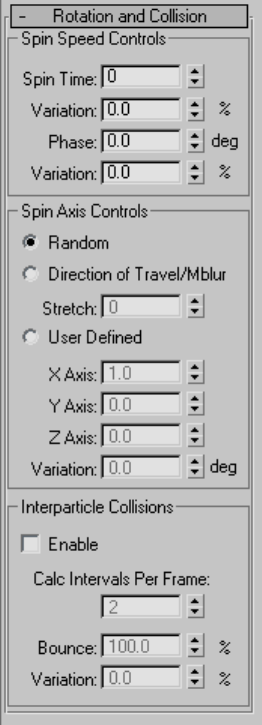
The options on this rollout affect the rotation of the particles, provide motion
blur effects, and control inter-particle collisions.
Interface
Spin Speed Controls group
Spin Time The number of frames for one rotation of a particle. If set to 0,
no rotation takes place.
Variation The percent of variation of the Spin Time.
2988 | Chapter 12 Space Warps and Particle Systems

Phase Sets the initial particle rotation, in degrees. This has no meaning for
fragments, which always begin with zero rotation.
Variation The percent of variation of the Phase.
Spin Axis Controls group
These options determine the spin axis for the particles, and provide a partial
method of applying motion blur to the particles.
Random The spin axis for each of the particles is random.
Direction of Travel/Mblur (Not available with the Blizzard particle system.)
Rotates the particles about a vector formed by the direction in which they're
moving. This option also lets you apply a form of motion blur to the particles
by using the Stretch spinner. For further information, see Achieving Particle
Motion Blur on page 2932 .
Stretch When greater than 0, the particles stretch along the travel axis,
depending on their speed. Specifically, the Stretch value specifies the percent
of their length per each unit of the Speed setting (in the Particle Motion group).
Thus, if you set Stretch to 2 while Speed is set at 10, the particles are stretched
20 percent longer than their original size along the axis of their travel. This
spinner is available only when you choose Direction of Travel/Mblur.
NOTE For best results when using Stretch, you should also assign the Particle
MBlur map as an opacity map of the material assigned to the particle system.
User Defined Uses a vector defined in the three X, Y, and Z axis spinners.
X/Y/Z Axis Specifies the spin vector of the X, Y, or Z axis, respectively. These
spinners are available only when User Defined is chosen.
Variation The amount, in degrees, by which the spin axis of each particle
may vary from the specified X Axis, Y Axis, and Z Axis settings. This spinner
is available only when you choose User Defined.
Interparticle Collisions group
These options enable collisions between particles, and control how the
collisions occur. Note that this involves intensive calculation, particularly
when large numbers of particles are involved.
Enable Enables inter-particle collisions in the calculation of the particle
movements.
Non-Event-Driven Particle Systems | 2989
Calc Intervals Per Frame The number of intervals per rendering interval,
during which an inter-particle collision test is conducted. The higher the value,
the more accurate the simulation, but the slower the simulation will run.
Bounce The degree to which speed is recovered after a collision.
Variation The percentage of random variation of the Bounce value, applied
to the particles.
Object Motion Inheritance Rollout
Create panel > Geometry button > Choose Particle Systems from the drop-down
list. > Object Type rollout > SuperSpray/Blizzard/Parray/PCloud > Object
Motion Inheritance rollout
Select a SuperSpray/Blizzard/Parray/PCloud emitter. > Modify panel > Object
Motion Inheritance rollout
Each particle's position and direction of movement are determined by the
position and orientation of the emitter at the time the particle is created. If
the emitter is moving through the scene, particles are scattered along the
emitter's path.
Use these options to affect the motion of the particles by the motion of the
emitter.
Procedures
Example: To observe object motion inheritance:
1Create a Super Spray particle system.
2Animate the emitter moving sideways (perpendicular to the direction of
the particle stream) between frames 1 and 15.
3Play the animation while observing it from the Top viewport.
The emitter stops at frame 15, while the particles it has emitted up to
that point continue moving along the diagonal between the emitter's
path and that of the particles. The remaining particles move straight out
from the emitter.
4On the Object Motion Inheritance rollout, set Influence to 50.
5Play the animation again.
2990 | Chapter 12 Space Warps and Particle Systems
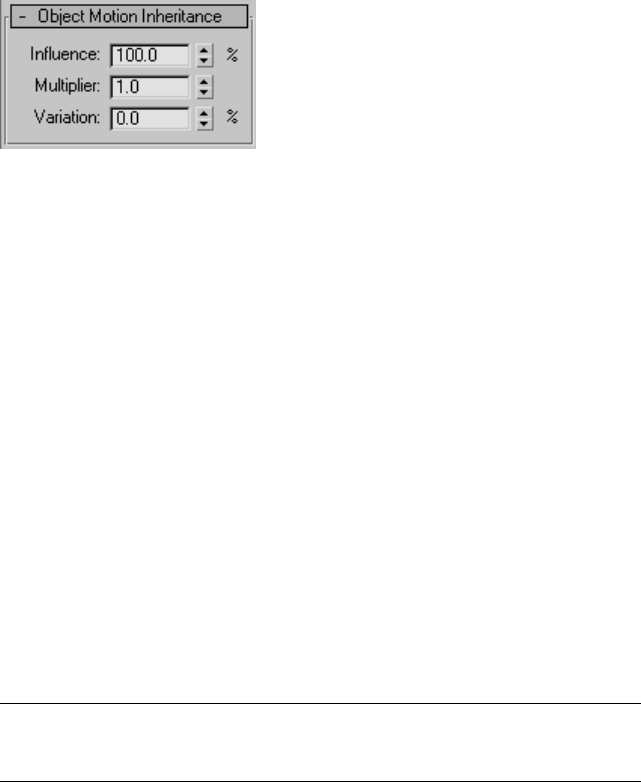
This time, only some of the particles inherit the emitter's motion, while
the rest move straight out from the emitter. Note that the latter form a
diagonal stream because each particle emerges at a subsequent point on
the emitter path.
Interface
Influence The percent of particles that inherit the motion of the object-based
emitter at the moment of particle formation. For example, when this is set at
100 (the default), all particles travel along with a moving object; when it's set
at 0, none of the particles are affected by the translation of the object and fall
behind its movement.
Multiplier Modifies the amount by which the emitter motion affects the
particle motion. This can be a positive or negative number.
Variation Provides a percentage of variation of the Multiplier value.
Bubble Motion Rollout
Create panel > Geometry button > Choose Particle Systems from the drop-down
list. > Object Type rollout > SuperSpray/Parray/PCloud > Bubble Motion rollout
Select a SuperSpray/Parray/PCloud emitter. > Modify panel > Bubble Motion
rollout
Bubble motion provides the wobbling effect you see in bubbles rising
underwater. Typically, it's used when the particles are set to rise in thin streams.
Bubble motion is similar to a waveform, and the Bubble Motion parameters
let you adjust the amplitude, period, and phase of the bubble "wave."
NOTE The bubble motion is not affected by space warps, so you can use a space
warp to control the direction of the particle flow without altering the local,
wobbling bubble effect.
Non-Event-Driven Particle Systems | 2991
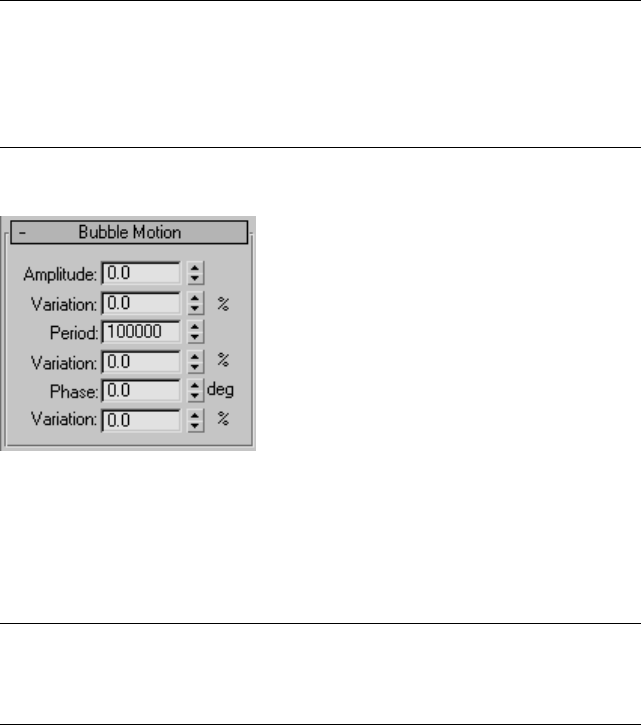
TIP InterParticle Collisions, Deflector Binding, and Bubble Noise do not get along
well together. Particles may leak through the deflector when these three are used
together. Instead of bubble motion, use animated mapping. Use facing particles
with an animated map of a bubble, where the bubble is smaller than the map
size. The bubble is animated moving around the map. This simulates bubble
motion at the map level.
Interface
Amplitude The distance the particle moves off its usual velocity vector as it
travels.
Variation The percent of Amplitude variation applied to each particle.
Period The cycle time for one complete oscillation of a particle through the
bubble "wave." A recommended value might be 20 to 30 intervals.
NOTE Bubble motion is measured in time, not in rate, so a very large Period value
means the motion takes a long time to complete. Thus, there is no motion,
effectively. Period is therefore set to a very large default value so that the default
motion of this type is none.
Variation The percent of Period variation for each particle.
Phase The initial displacement of the bubble pattern along the vector.
Variation The percent of Phase variation for each particle.
Particle Spawn Rollout
Create panel > Geometry button > Choose Particle Systems from the drop-down
list. > Object Type rollout > SuperSpray/Blizzard/Parray/PCloud > Particle
Spawn rollout
2992 | Chapter 12 Space Warps and Particle Systems
Select a SuperSpray/Blizzard/Parray/PCloud emitter. > Modify panel > Particle
Spawn rollout
The options on the Particle Spawn rollout let you specify what happens to
particles when they die, or when they collide with a particle deflector. Using
the options on this rollout, you can have particles generate additional
generations of particles upon collision or death.
Non-Event-Driven Particle Systems | 2993

Interface
Particle Spawning Effects group
Choose one of these options to determine what happens to the particles at
either collision or death.
2994 | Chapter 12 Space Warps and Particle Systems

None Uses none of the spawning controls, and the particles act as they
normally would. That is, upon collision, they either bounce or stick, depending
on Particle Bounce settings in the deflector, and on death they disappear.
Die After Collision Particles disappear when they strike a deflector to which
they're bound, such as the SDeflector.
Persist The life, in frames, that the particle will persist after the collision.
Setting this to 0 (the default) causes particles to vanish immediately after the
collision.
Variation Varies the Persist value of each particle, when Persist is greater
than 0. This lets you "feather" the dying off of particle density.
Spawn on Collision Spawn effects take place upon collision with a bound
deflector.
Spawn on Death Spawn effects take place at the end of each particle's life.
Spawn Trails Particles are spawned from existing particles at each frame of
that particle's life. The Multiplier spinner specifies the number of particles
that are spawned from each particle. The base direction of the spawned particles
is opposite that of the parent's velocity. The Scale, Direction, and Speed Chaos
factors are applied to that base direction.
NOTE If the Multiplier is greater than 1, at least one of the three Chaos factors
must be greater than 0 in order to see the additional spawned particles. Otherwise,
the multiples will occupy the same space.
WARNING This option can produce many particles. For best results, begin by
setting Particle Quantity on the Particle Generation rollout to Use Rate and to 1.
Spawns The number of spawns beyond the original particle generation. For
example, if this is set to 1, and you're spawning at death, one spawning will
occur beyond the original lifespan of each particle.
Affects Specifies the percentage of particles that will spawn. Reducing this
reduces the number of particles that produce spawned particles.
Multiplier Multiplies the number of particles spawned at each spawning
event.
Variation Specifies a percentage range by which the Multiplier value will
vary, frame by frame.
Non-Event-Driven Particle Systems | 2995
Direction Chaos group
Chaos Specifies the amount by which the direction of the spawned particle
can vary from the direction of the parent particle. A setting of 0 means no
variance. A setting of 100 causes the spawned particle to travel in any random
direction. A setting of 50 causes the spawned particle to deviate from its
parent's path by up to 90 degrees.
Speed Chaos group
These options let you vary the spawned particles' speed randomly in relation
to their parents' speed.
Factor This is the range of a percentage of change in the speed of the spawned
particle relative to its parent. A value of 0 means no change.
Slow Applies the speed factor randomly to slow the speed of the spawned
particles.
Fast Randomly speeds up particles based on the speed factor.
Both Some particles speed up, while others slow down, based on the speed
factor.
Inherit Parent Velocity Spawned particles inherit the speed of their parents,
in addition to the effect of the speed factor.
Use Fixed Value Uses the Factor value as a set value, rather than as a range
applied randomly to each particle.
2996 | Chapter 12 Space Warps and Particle Systems
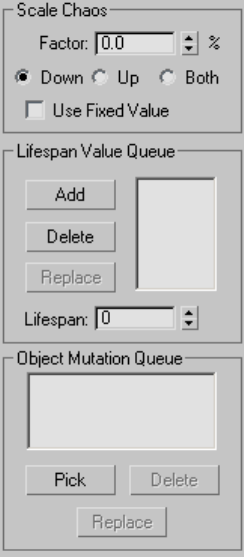
Scale Chaos group
These options apply random scaling to the particles.
Factor Determines a random percentage range of scaling of the spawned
particles relative to their parents, and dependent on the options below.
Down Randomly scales down spawned particles to be smaller than their
parents, based on the Factor value.
Up Randomly scales up spawned particles to be larger than their parents.
Both Scales spawned particles both larger and smaller than their parents.
Use Fixed Value Uses the Factor value as a fixed value, rather than a range
of values.
Lifespan Value Queue group
These options let you specify a list of alternative lifespan values for each
spawned generation of particles. The spawned particles use these lifespans
Non-Event-Driven Particle Systems | 2997
rather than the lifespan specified for the original particles in the Life spinner
on the Particle Generation rollout on page 2973 .
List window Displays a list of lifespan values. The first value on the list is
used for the first generation of spawned particles, the next value is used for
the next generation, and so on. If there are fewer values on the list than there
are spawnings, then the last value is used repeatedly for all remaining
spawnings.
Add Adds the value in the Lifespan spinner to the list window.
Delete Deletes the currently highlighted value in the list window.
Replace Lets you replace a value in the queue with a value in the Lifespan
spinner. To use, first place a new value in the Lifespan spinner, then select
the value in the queue you want to replace, and click the Replace button.
Lifespan Use this to set a value, and then click the Add button to add the
value to the list window.
Object Mutation Queue group
The options in this group let you switch between instanced-object particles
with each spawning (as set with the Spawns spinner). These options are
available only if Instanced Geometry is the current particle type.
List window Displays a list of objects to be instanced as particles. The first
object on the list is used for the first spawning, the second for the second
spawning, and so on. If there are fewer objects on the list than there are
spawnings, then the last object on the list is used for all remaining spawnings.
Pick Click this, and then select an object in the viewport to add to the list.
Note that the type of object you use is based on the settings in the Instancing
Parameters group of the Particle Type rollout. For example, if you've turned
on Subtree in that group, you can pick object hierarchies. Likewise, if you've
picked a group, you can use groups as your spawned particles.
Delete Deletes the currently highlighted object in the list window.
Replace Replaces an object in the queue with a different object. Select an
object in the queue to enable the Replace button. Click Replace, and then pick
an object in the scene to replace the highlighted item in the queue.
2998 | Chapter 12 Space Warps and Particle Systems
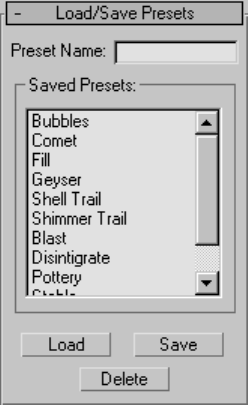
Load/Save Presets Rollout
Create panel > Geometry button > Choose Particle Systems from the drop-down
list. > Object Type rollout > SuperSpray/Blizzard/Parray/PCloud > Load/Save
Presets rollout
Select a SuperSpray/Blizzard/Parray/PCloud emitter. > Modify panel > Load/Save
Presets rollout
These options let you store preset values that can be used in other, related
particle systems. For example, after setting parameters for a PArray and saving
it under a specific name, you can then select another PArray system, and load
the preset values into the new system.
Interface
Preset Name An editable field in which you can define a name for your
settings. Click the Save button to save the preset name.
Saved Presets Contains all the saved preset names. A number of presets are
included with 3ds Max; to see what they do, create a particle system, load a
preset, and play back the animation. Some of the presets, such as Particle
Array's Shimmer Trail, are most effective with moving particle systems.
Load Loads the preset currently highlighted in the Saved Presets list.
Alternatively, double-click the preset name in the list to load it.
Non-Event-Driven Particle Systems | 2999

Save Saves the current name in the Preset Name field and places it in the
Saved Presets window.
Delete Deletes the selected items in the Save Presets window.
NOTE Animated parameter values subsequent to frame 0 are not stored.
3000 | Chapter 12 Space Warps and Particle Systems